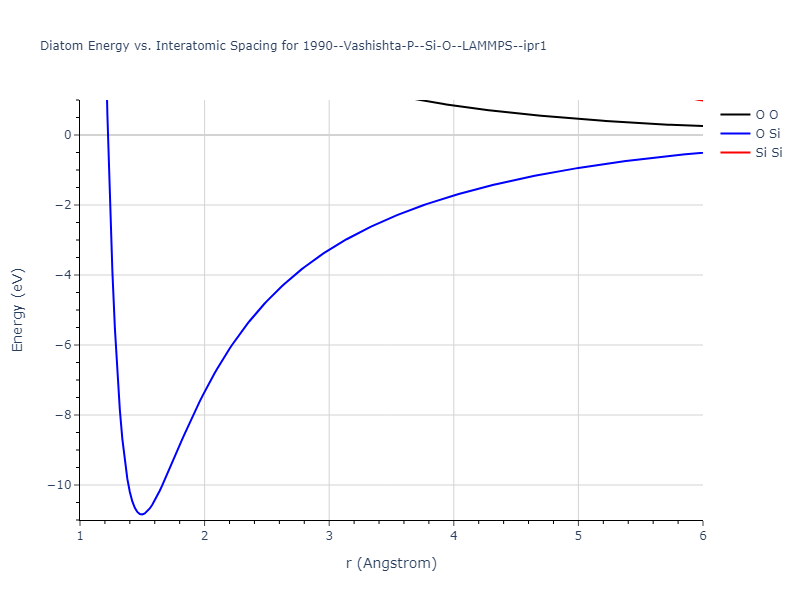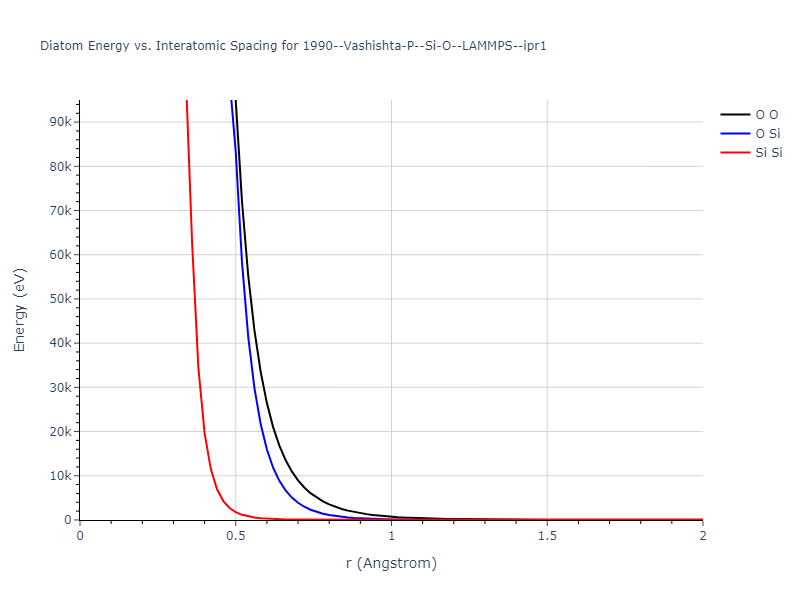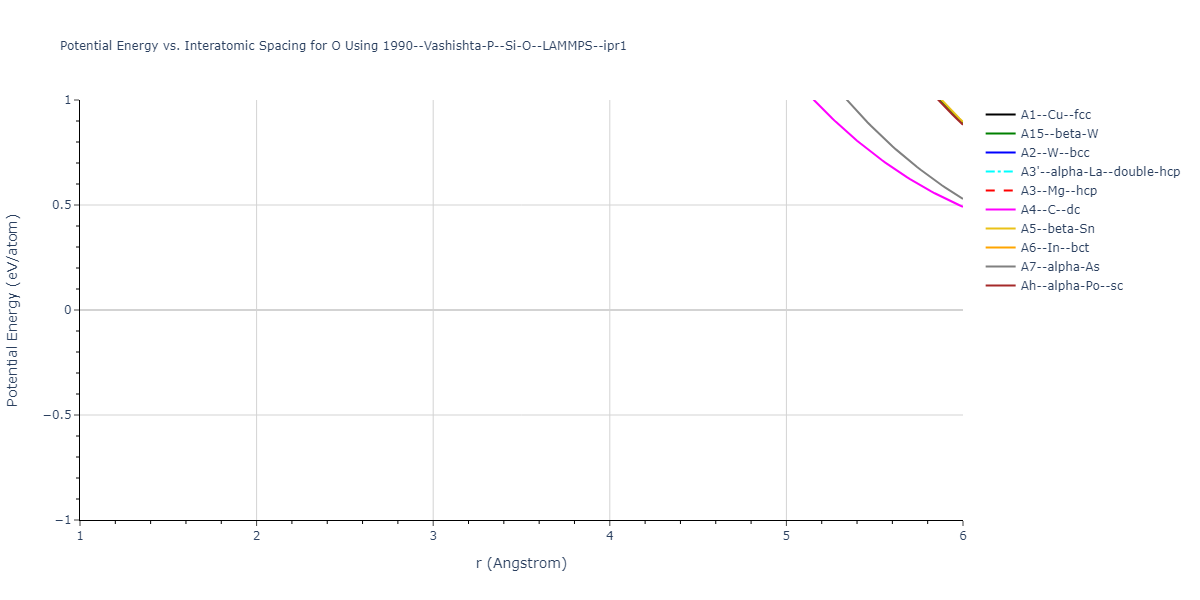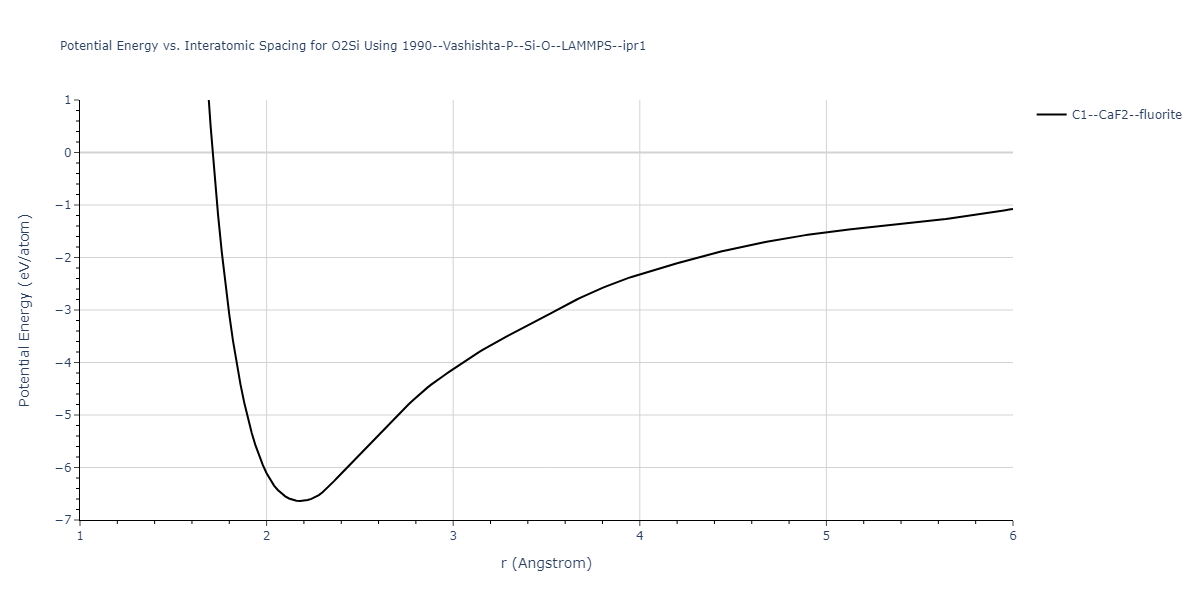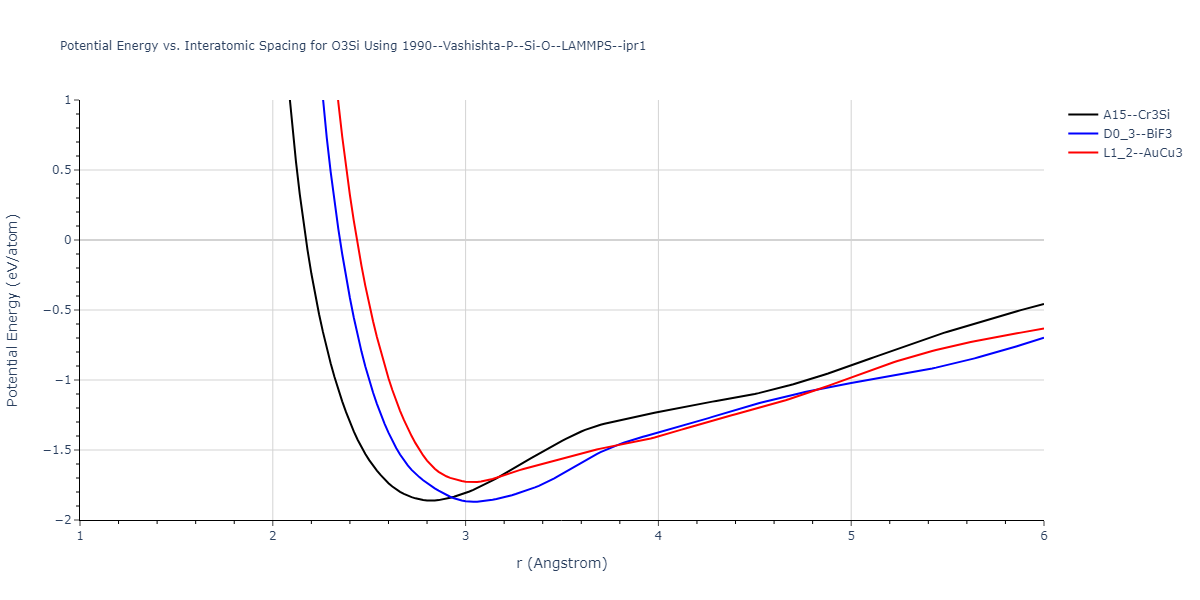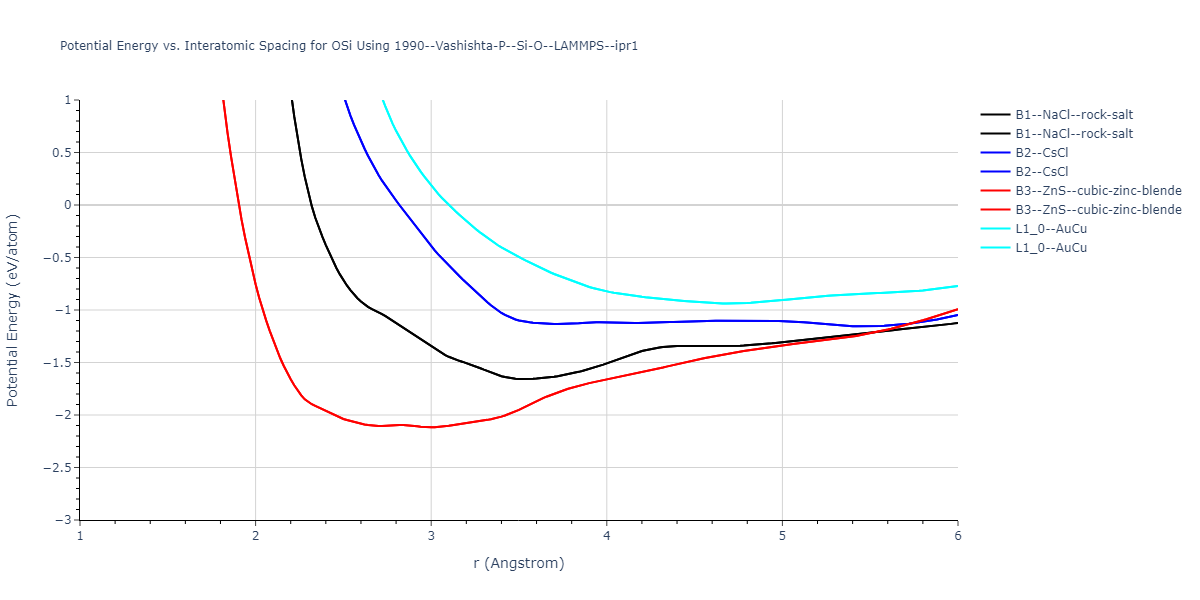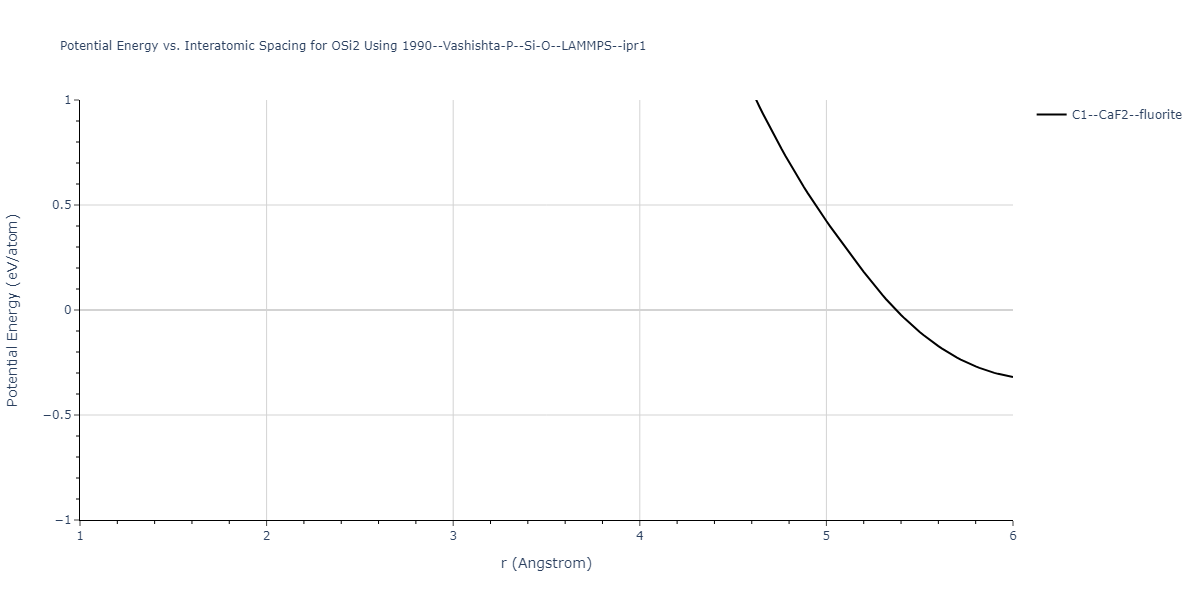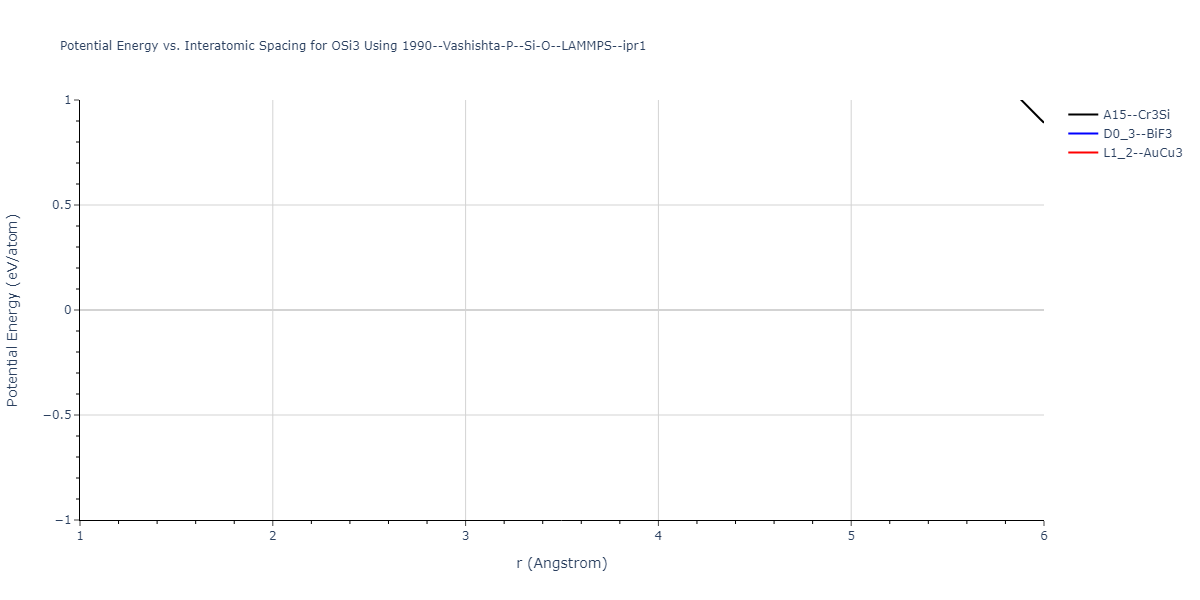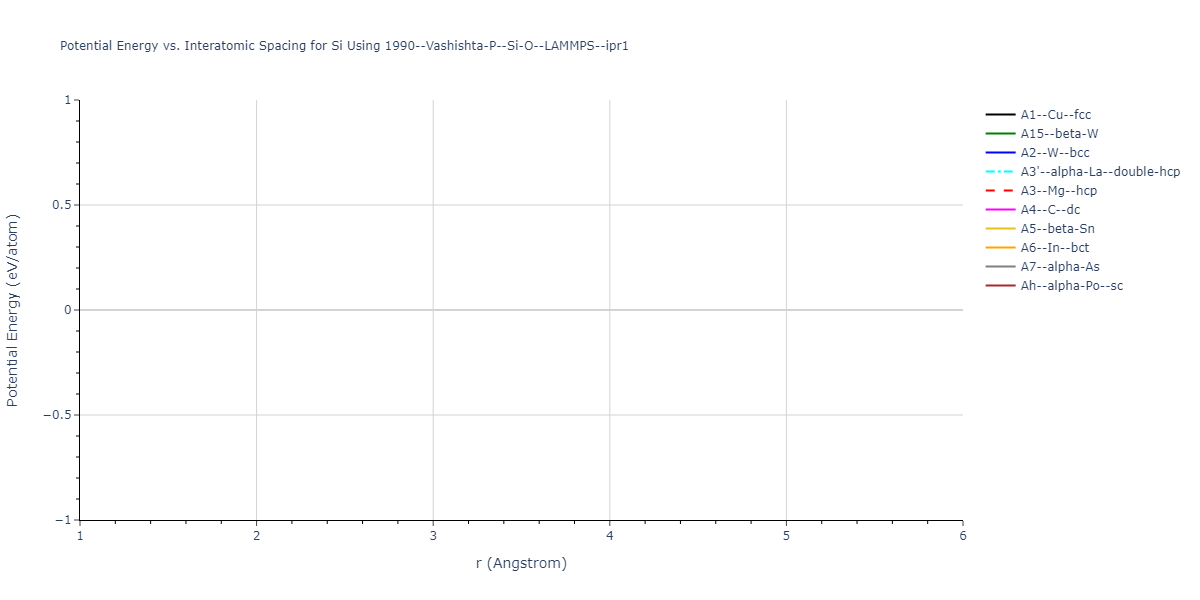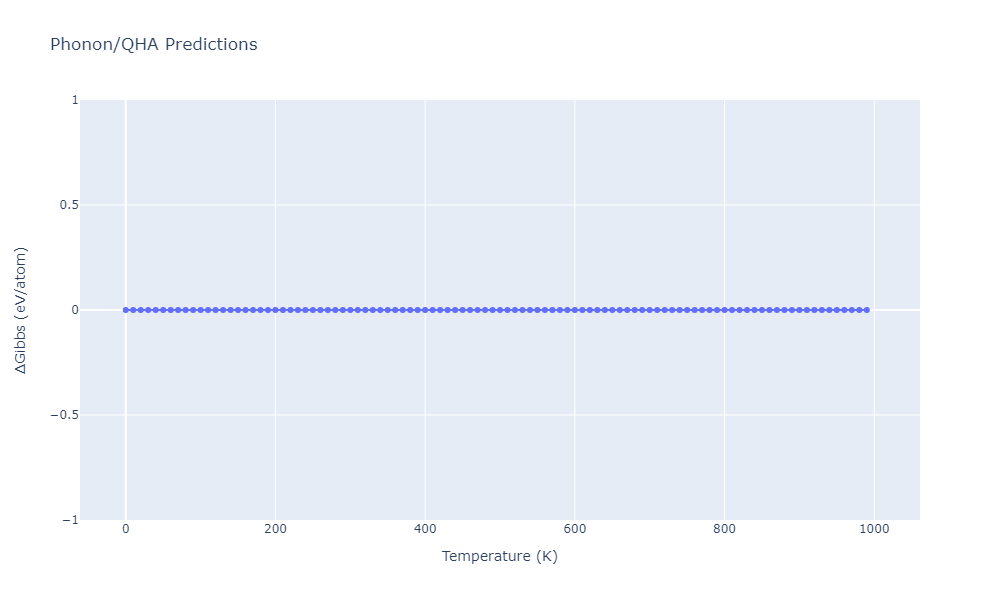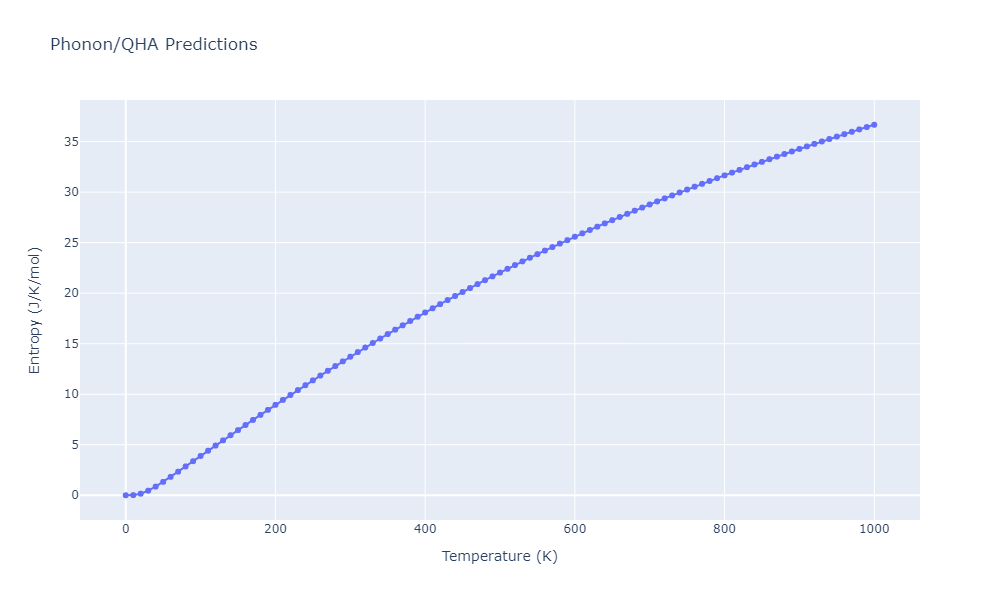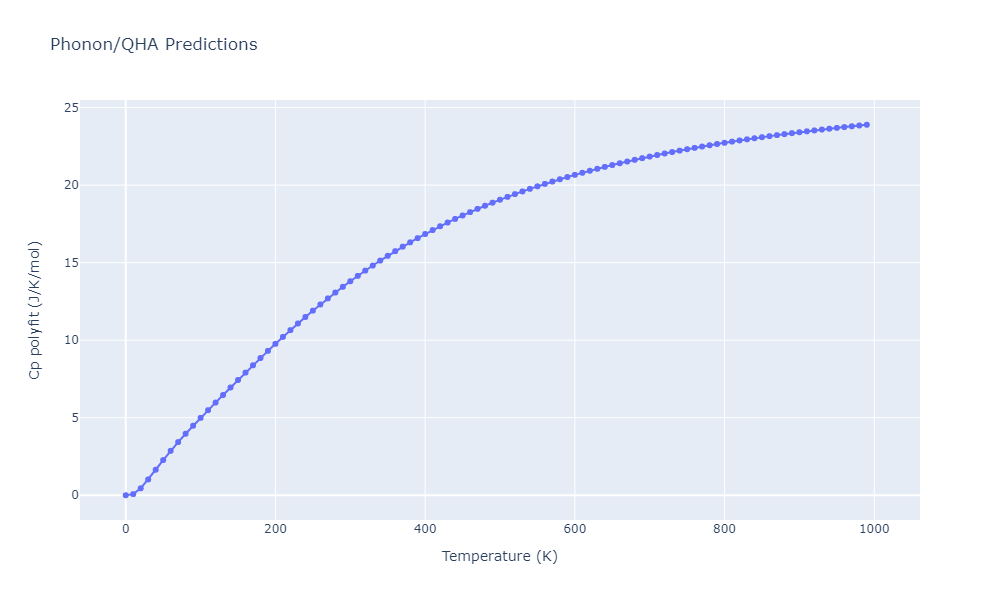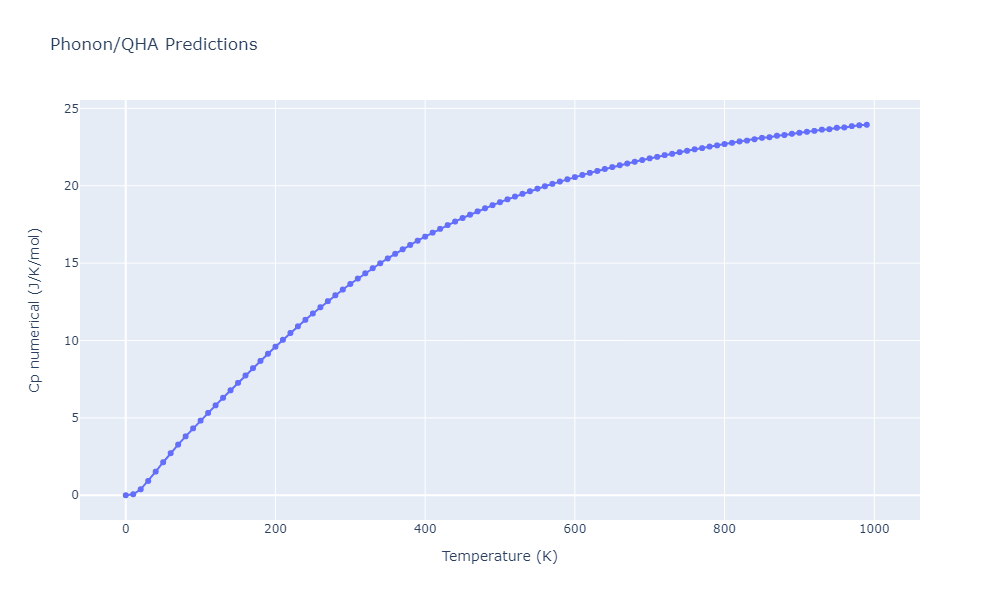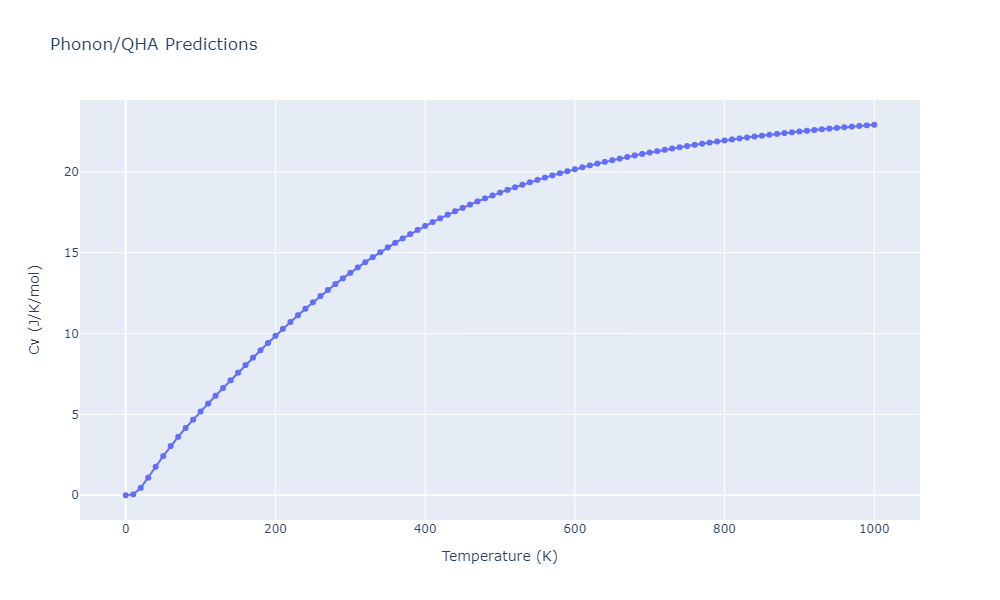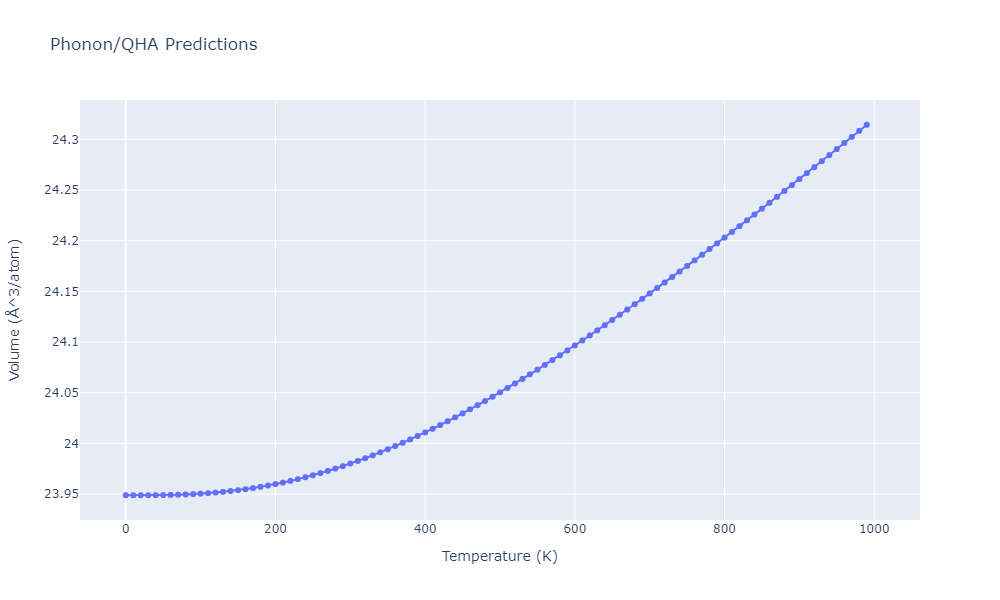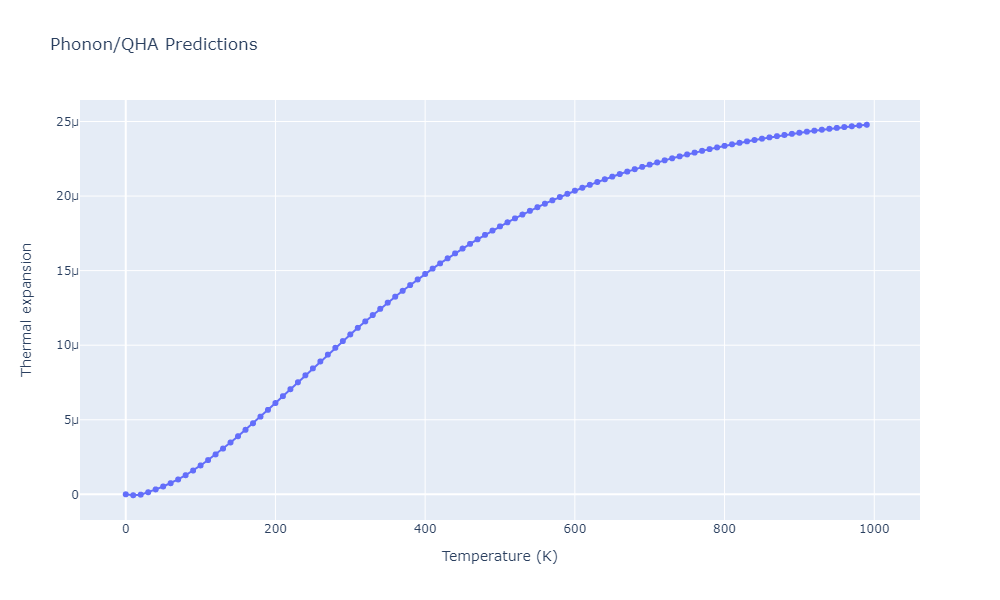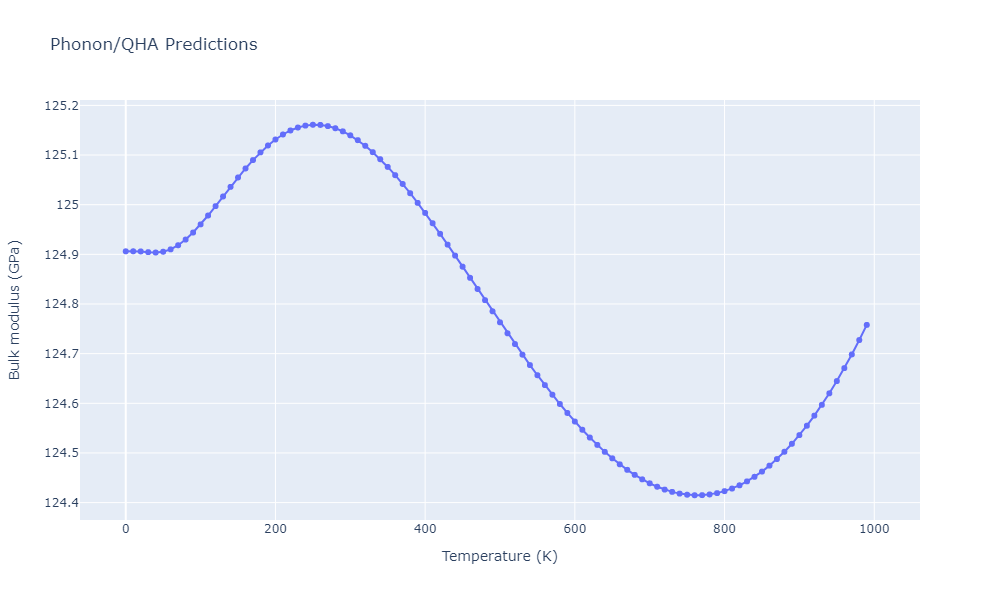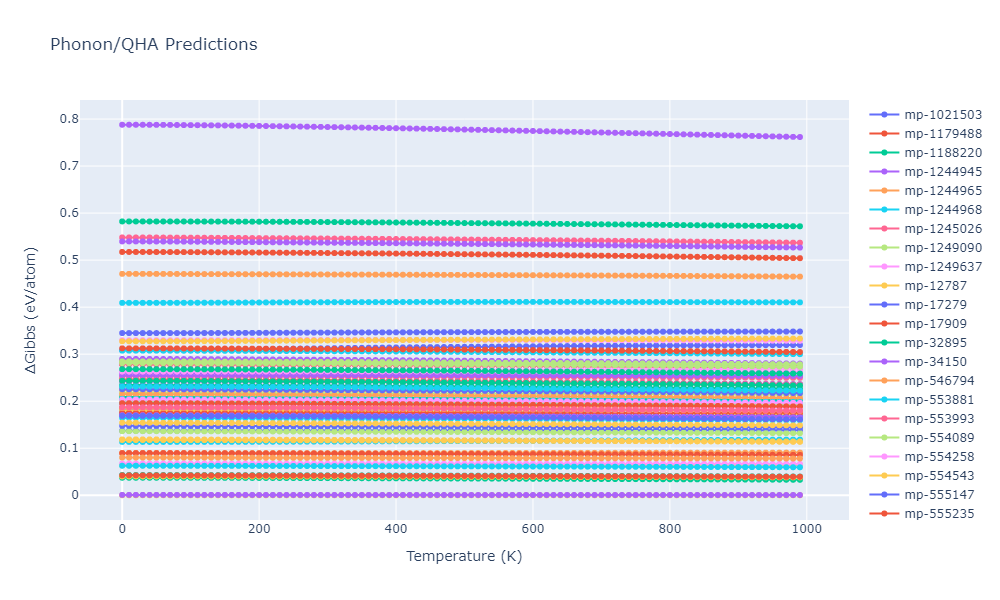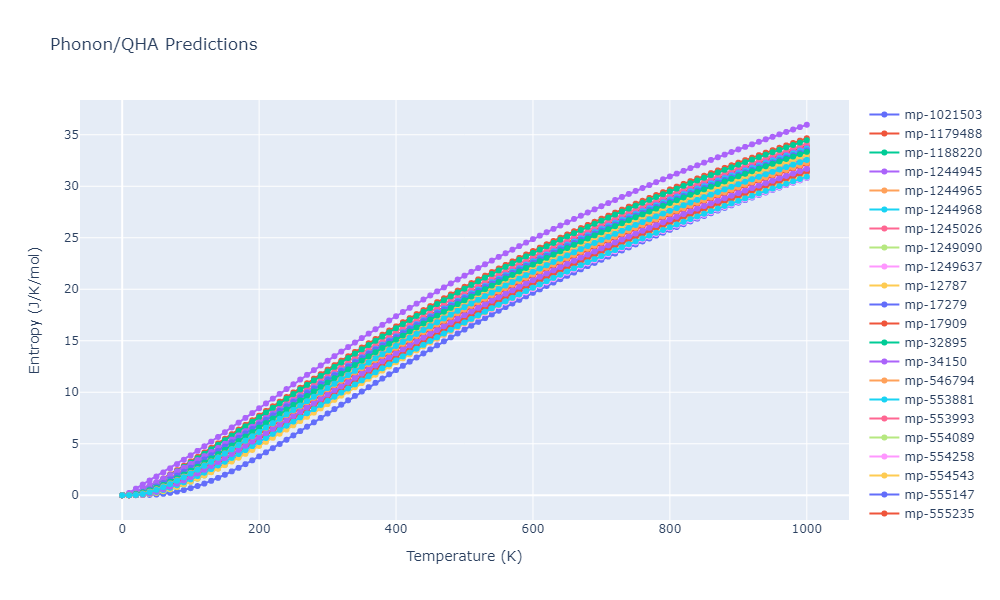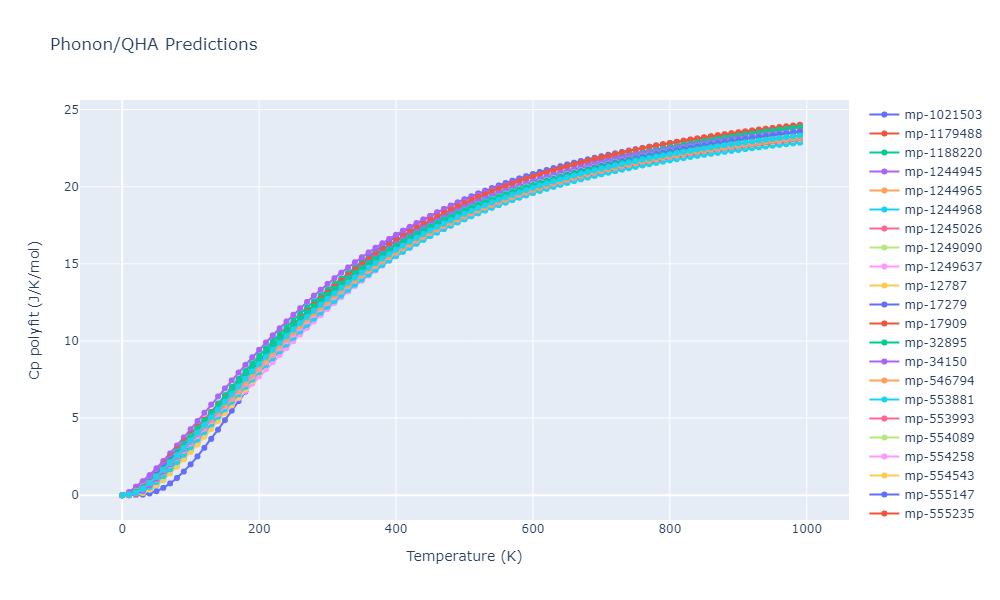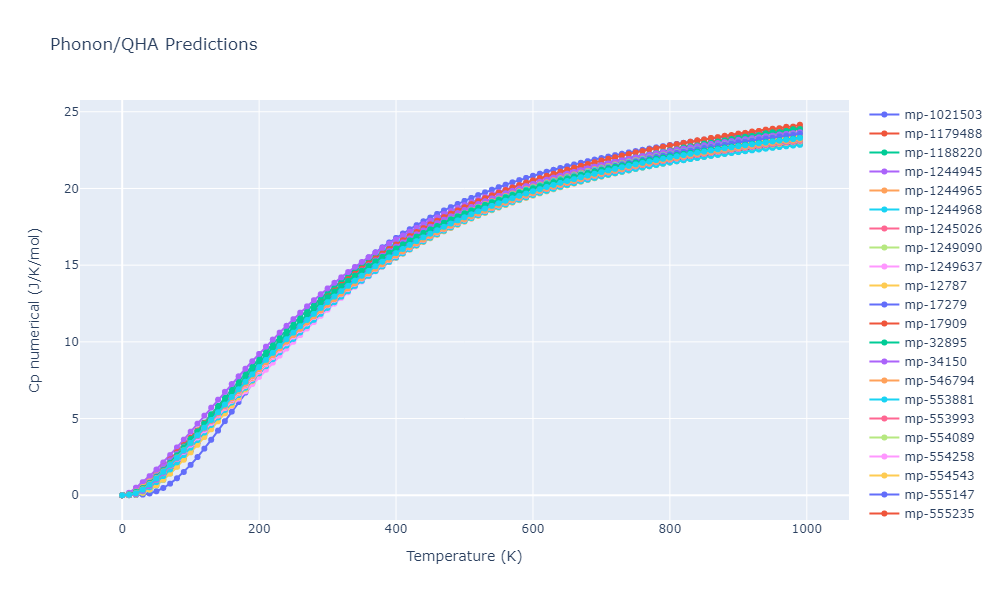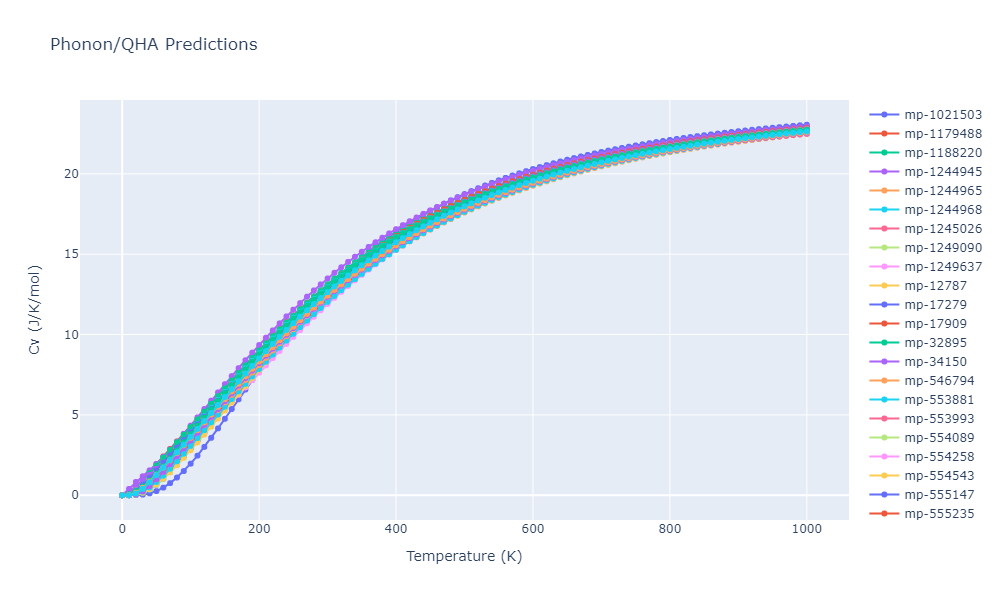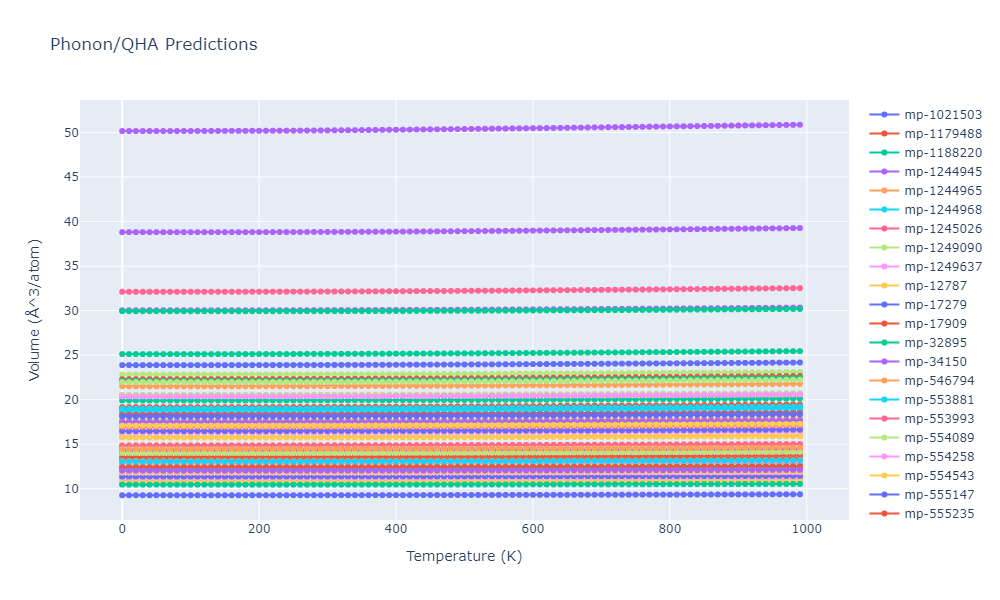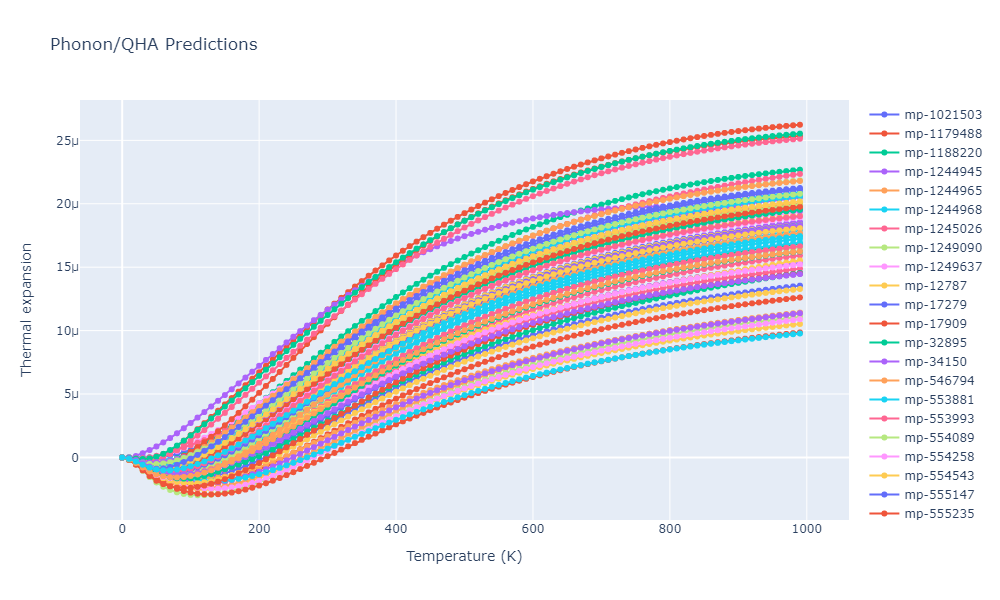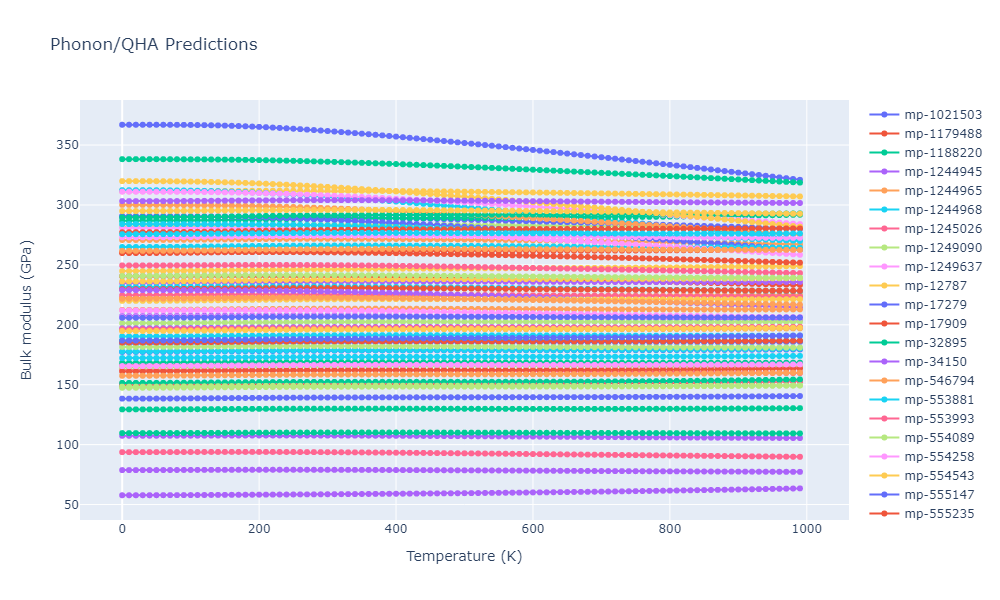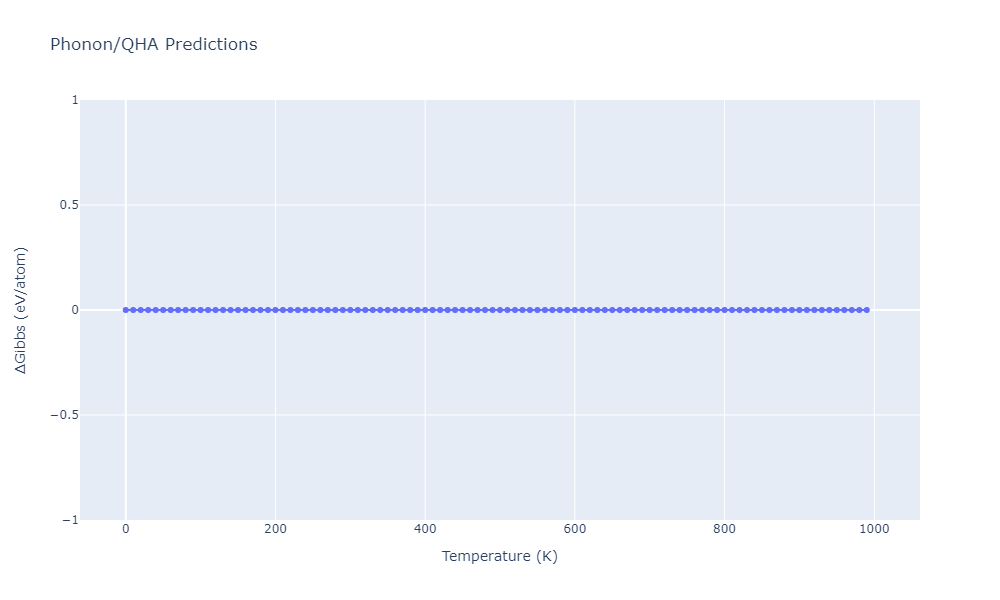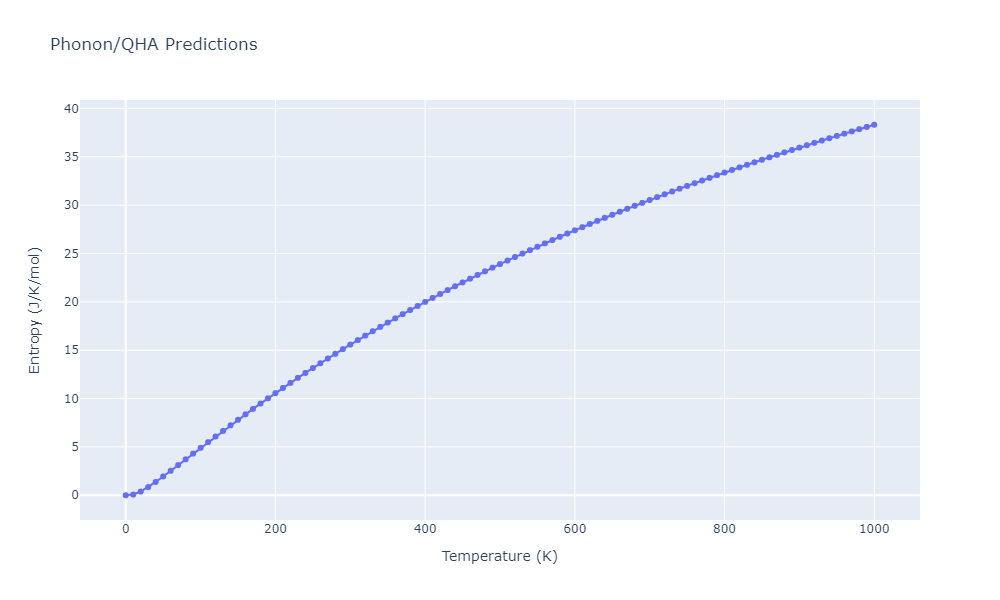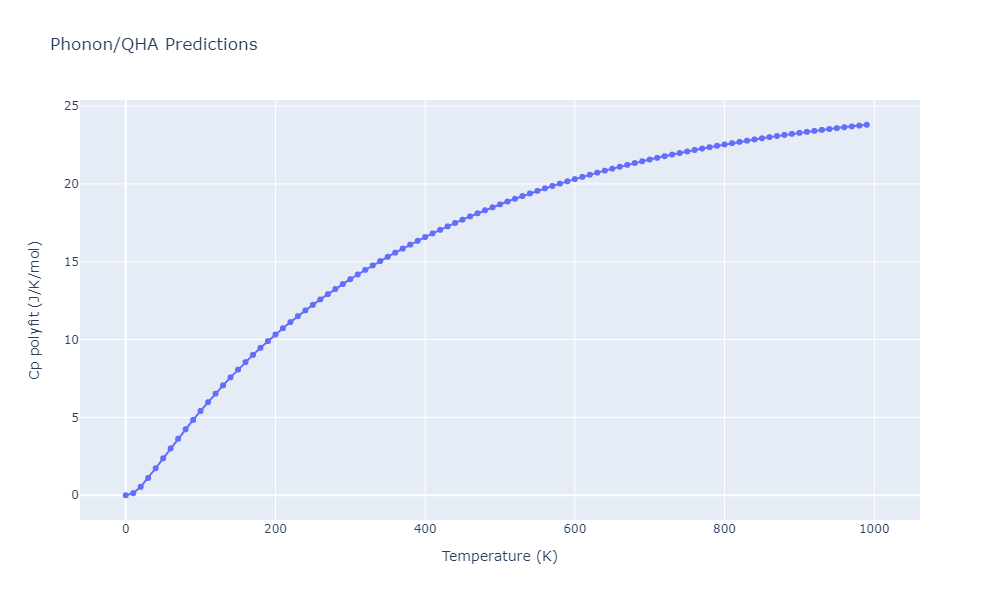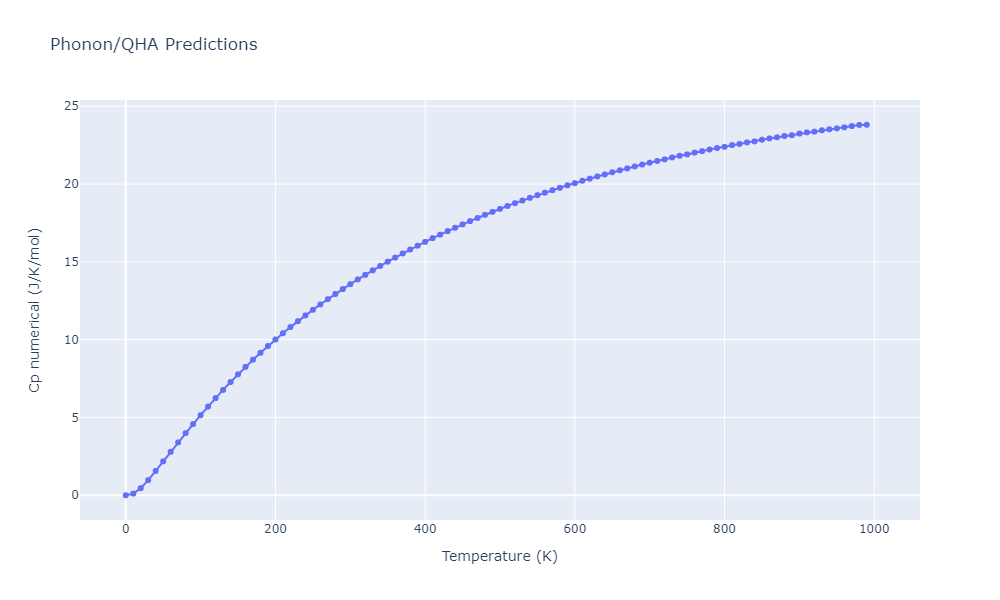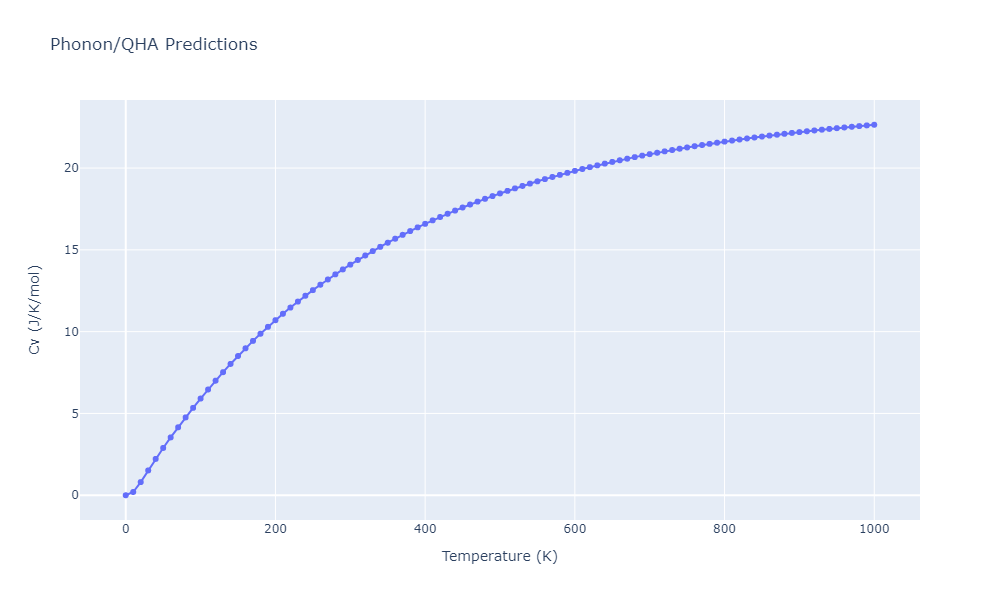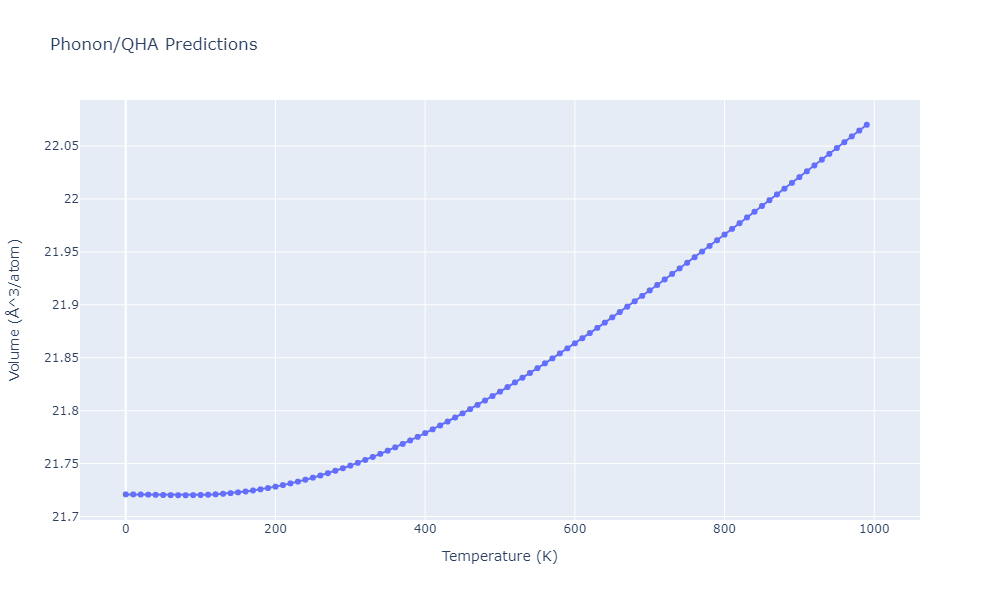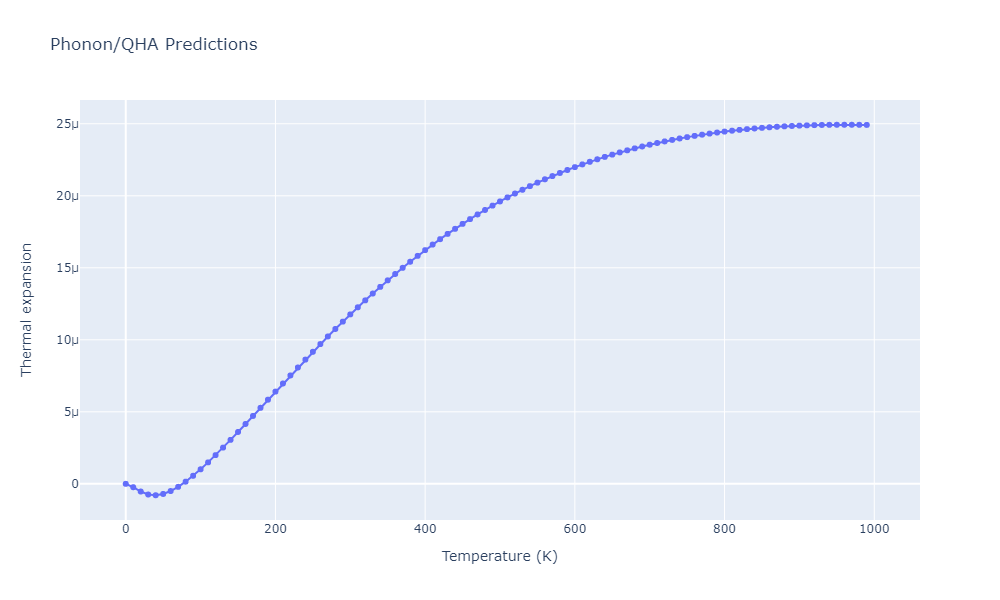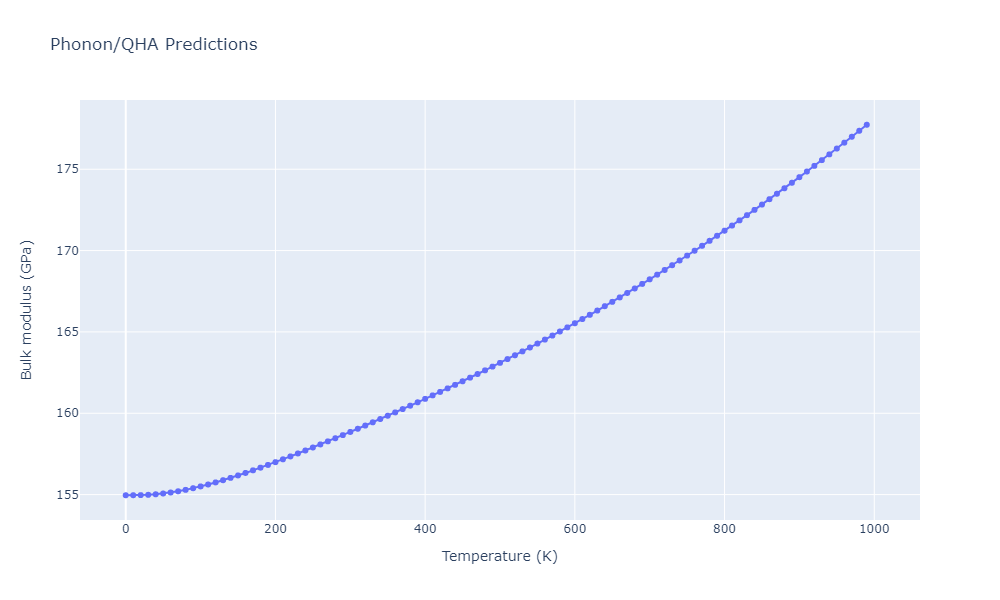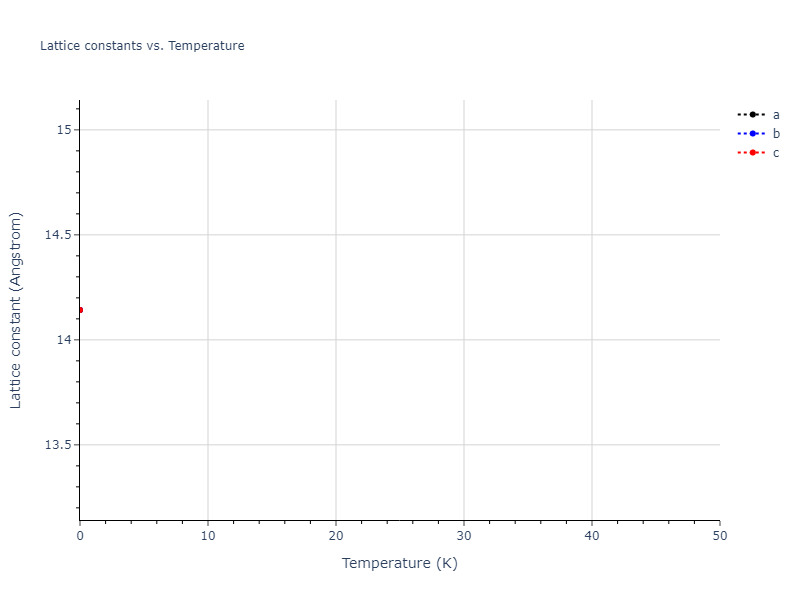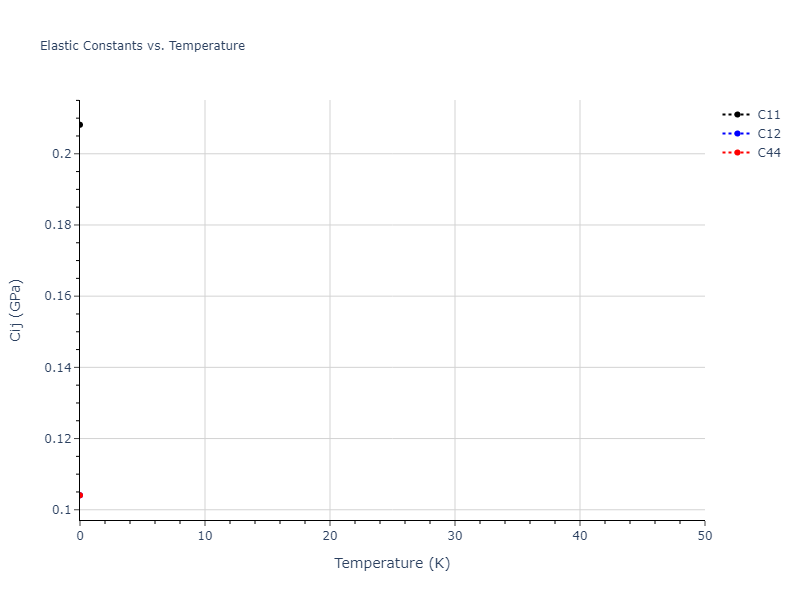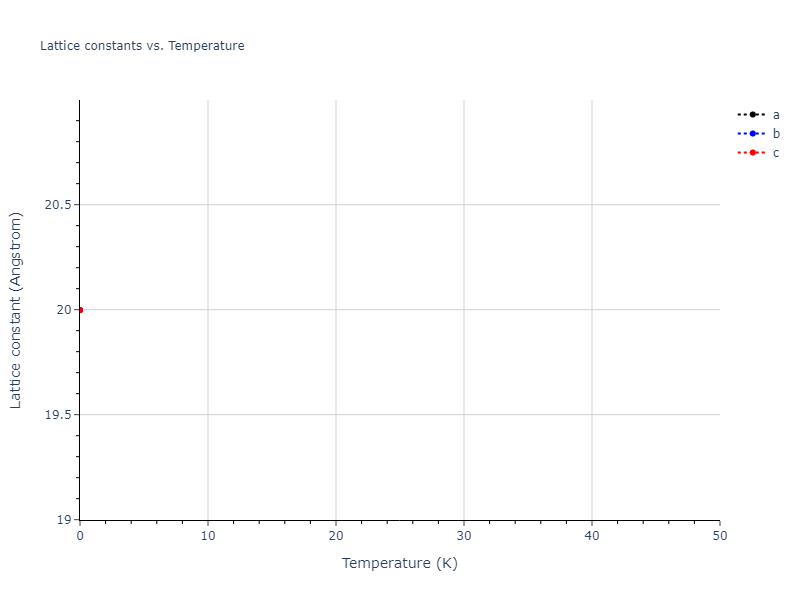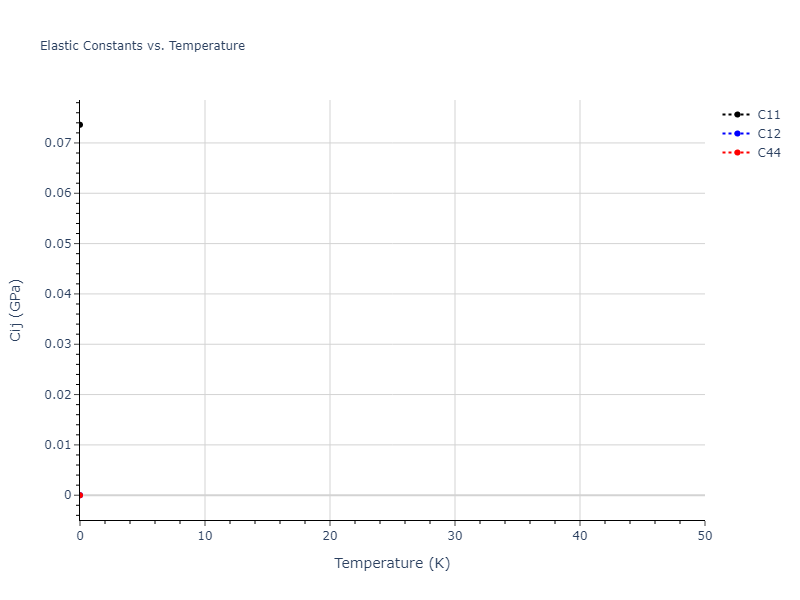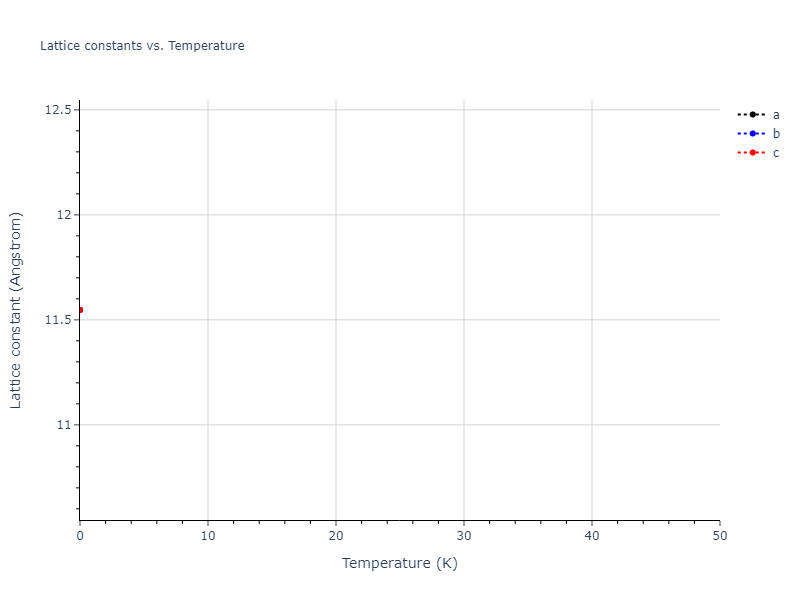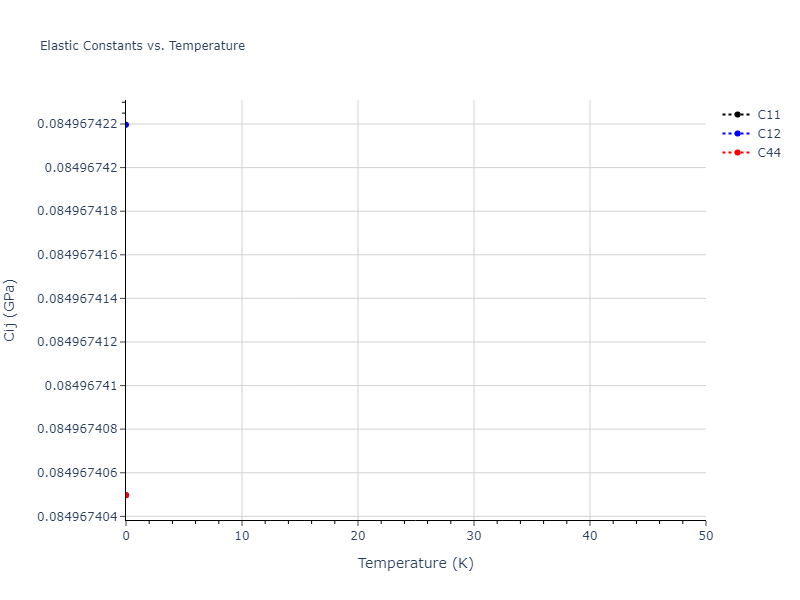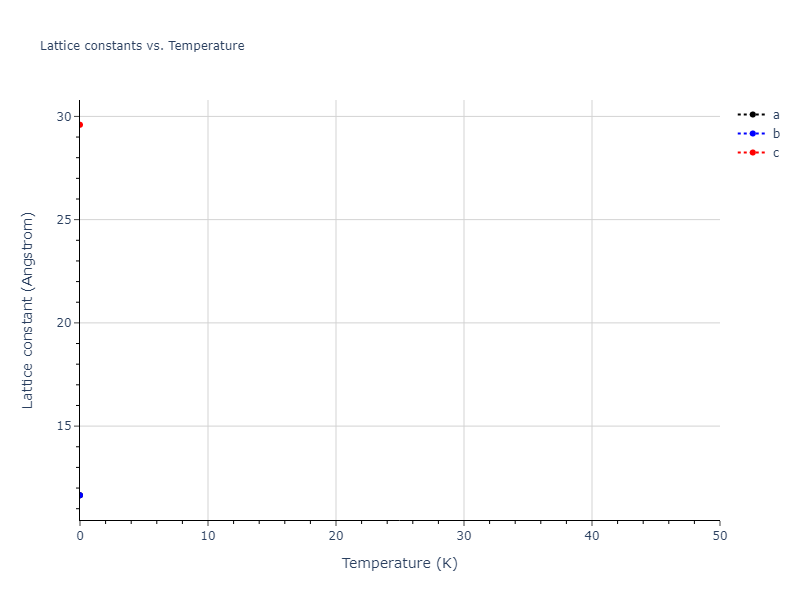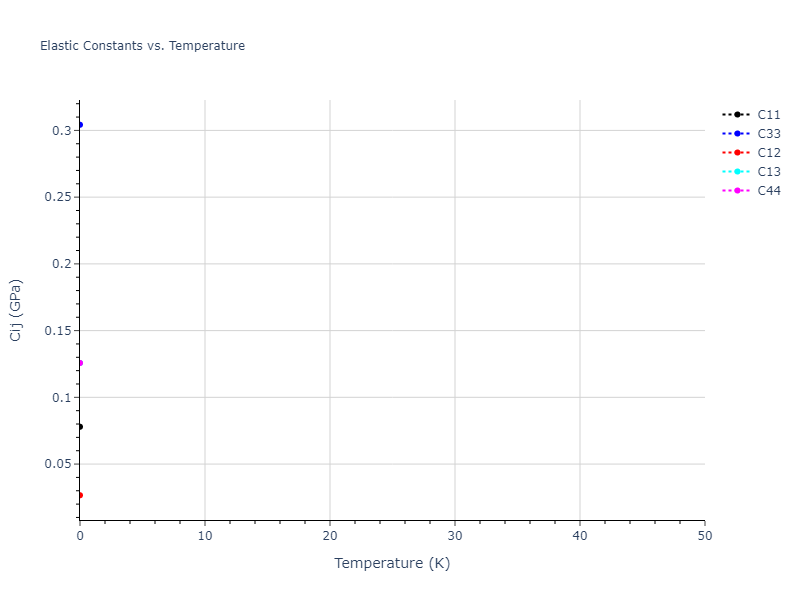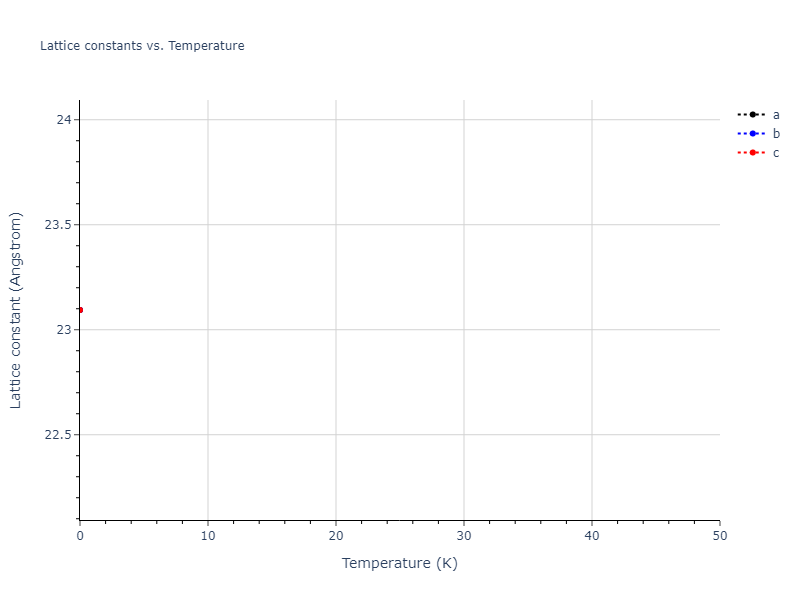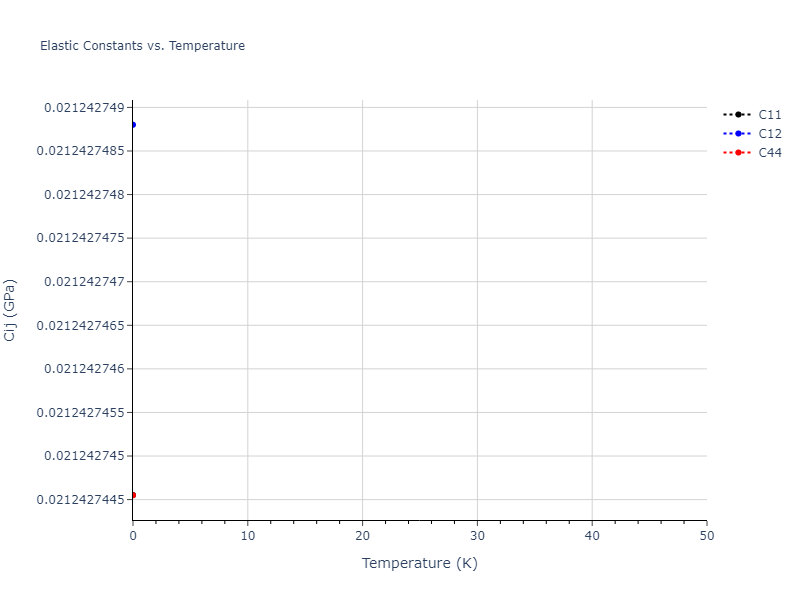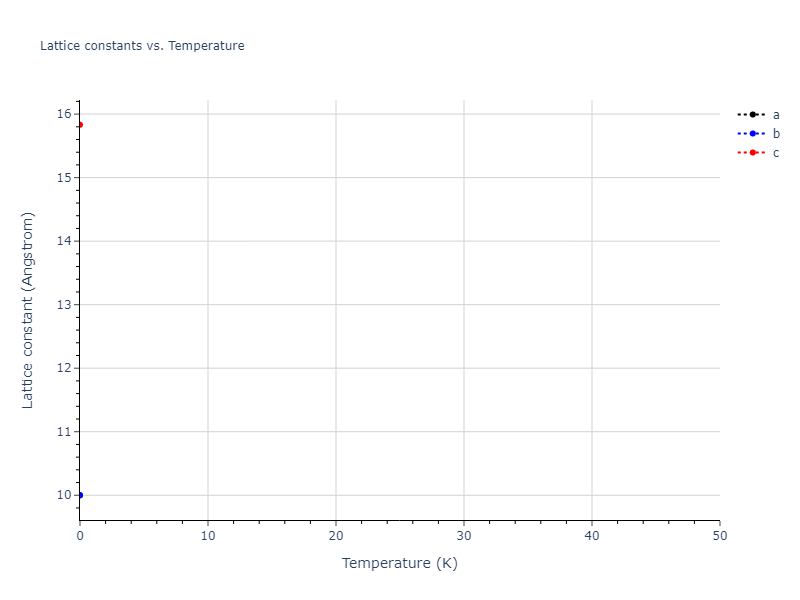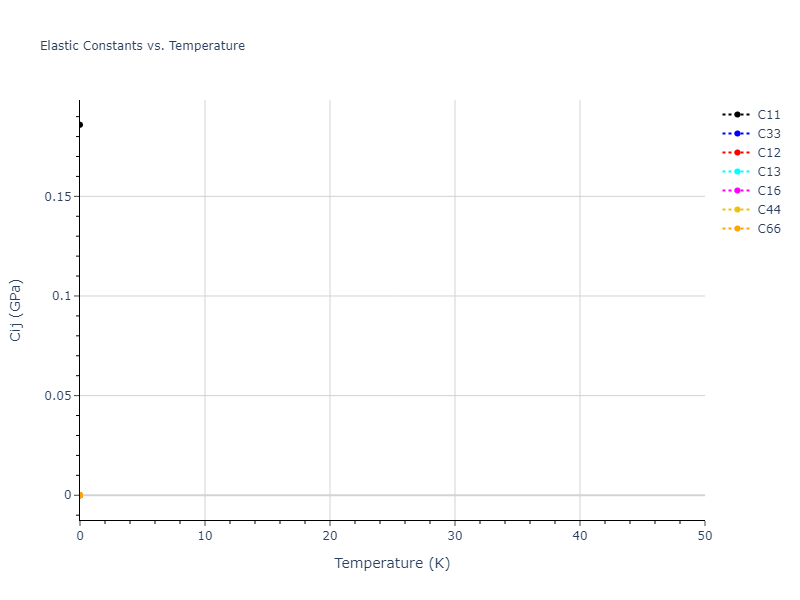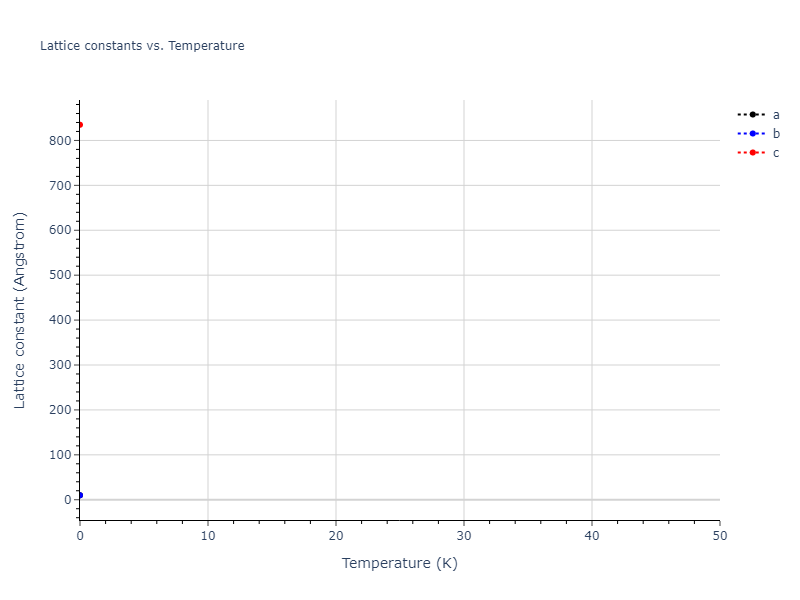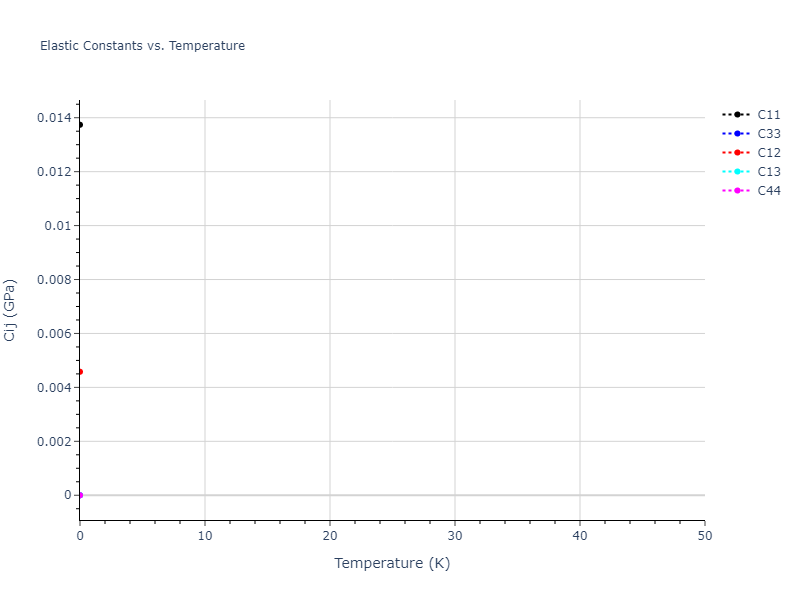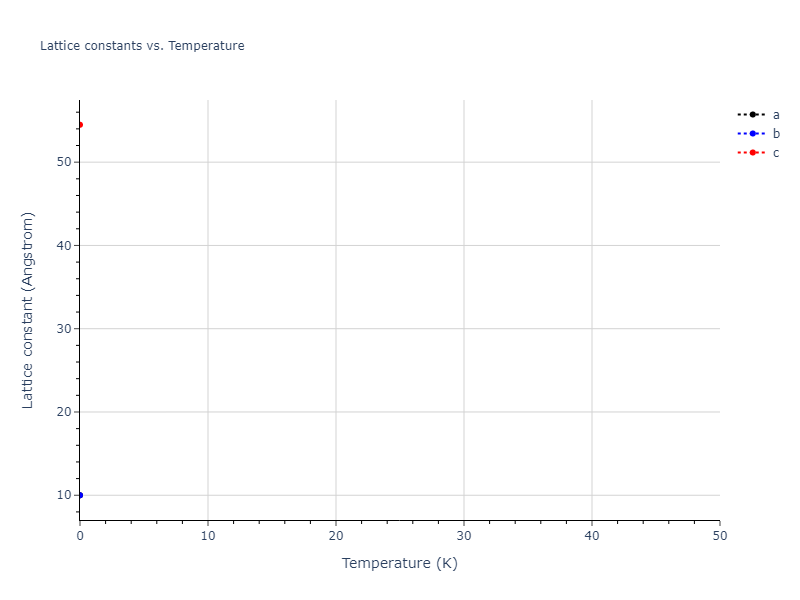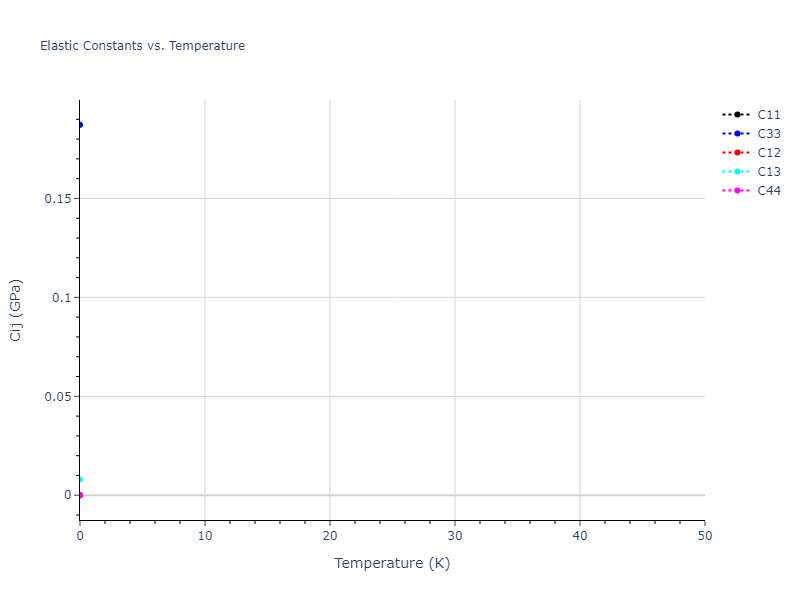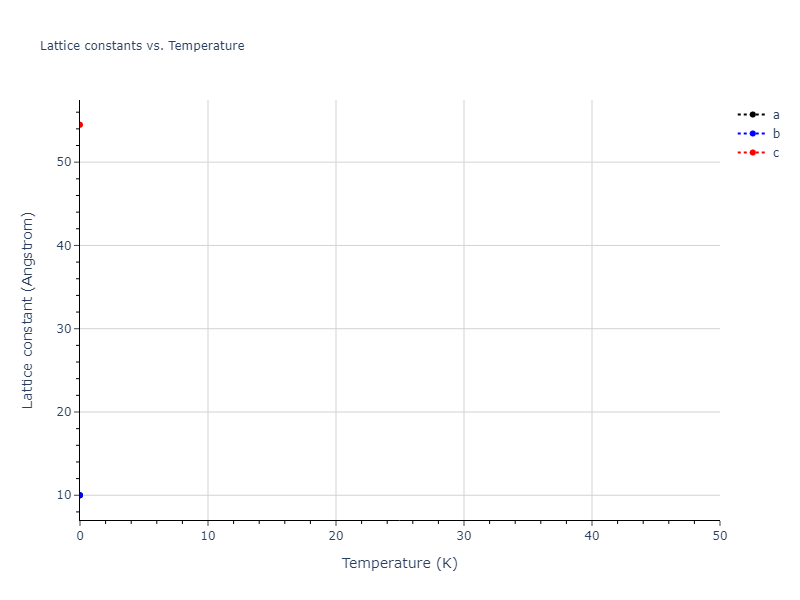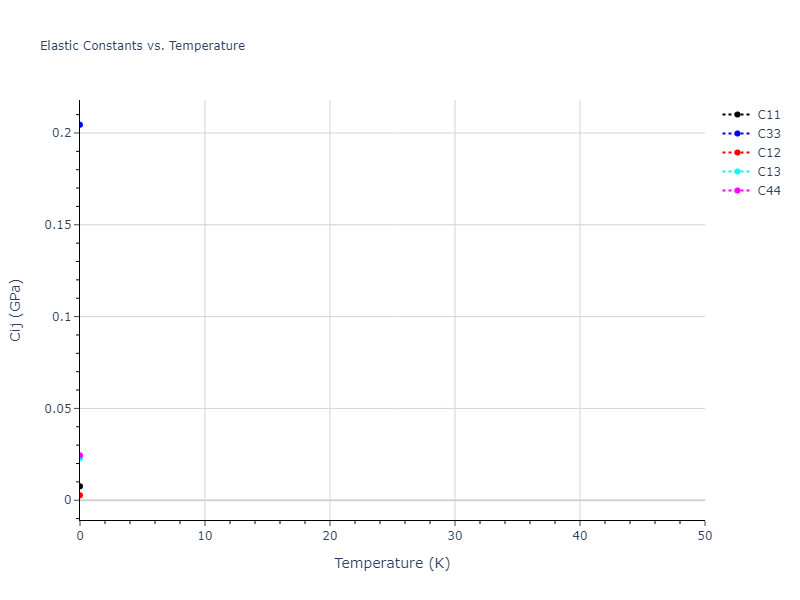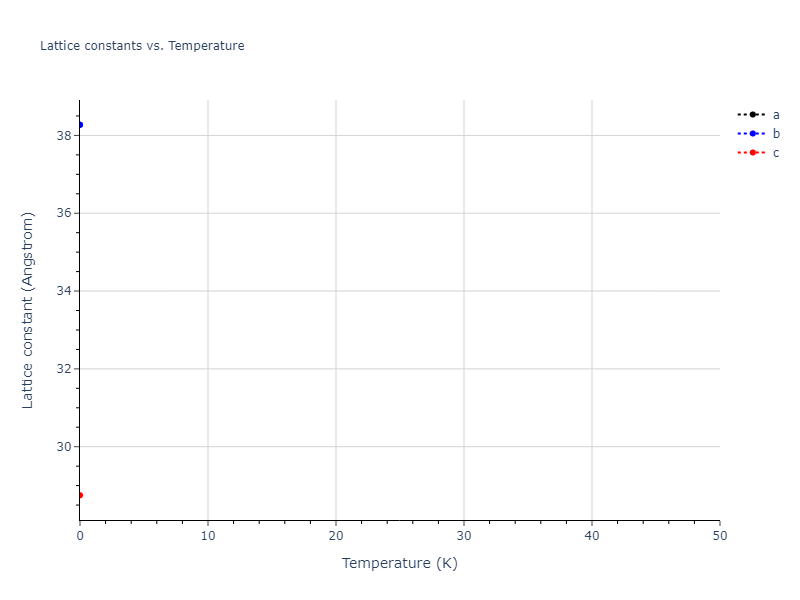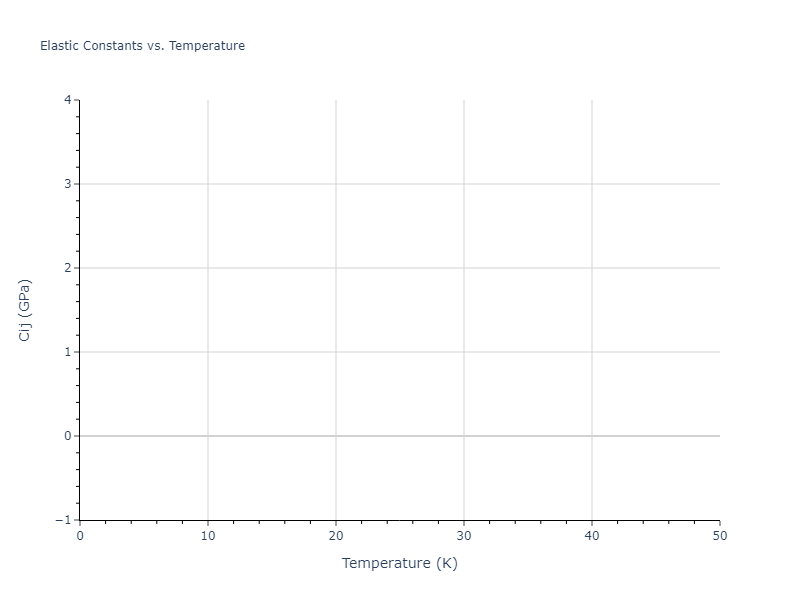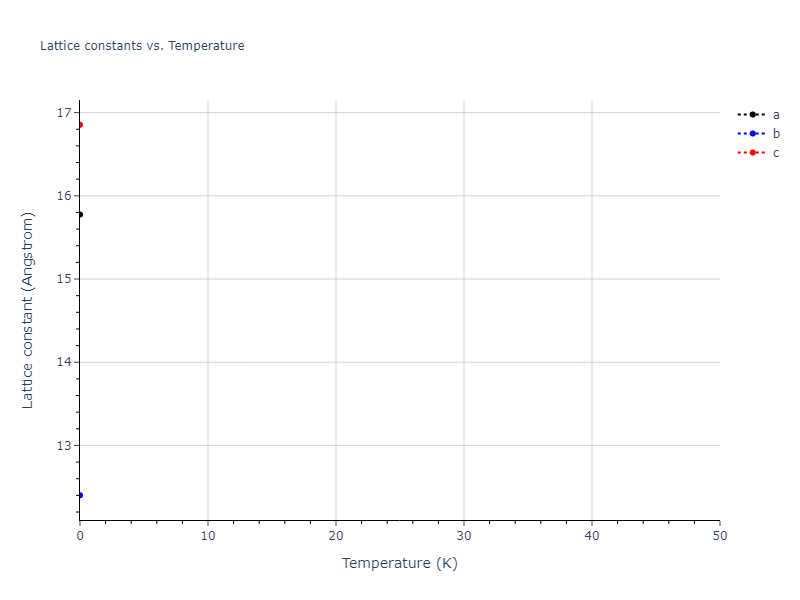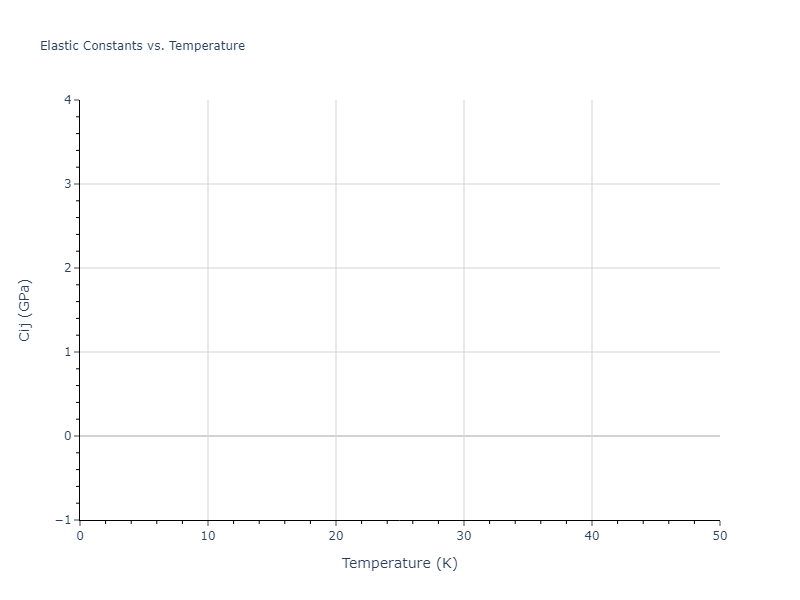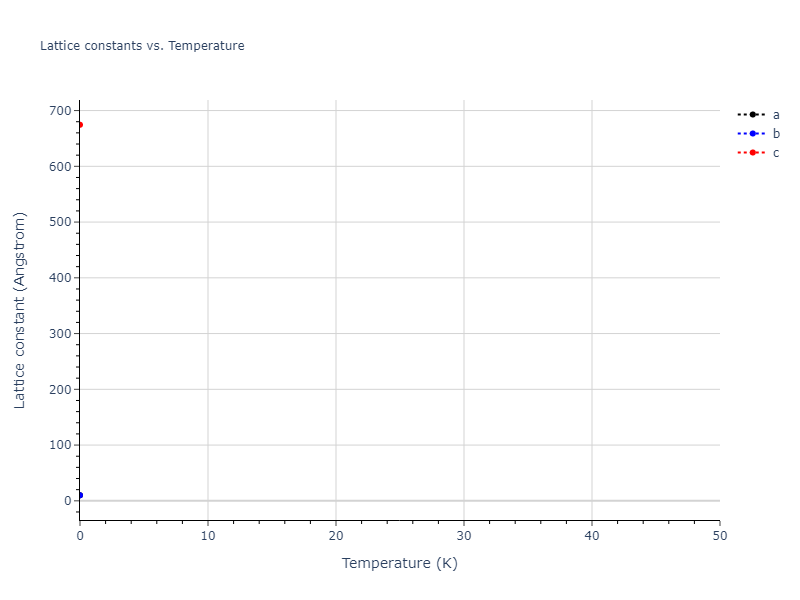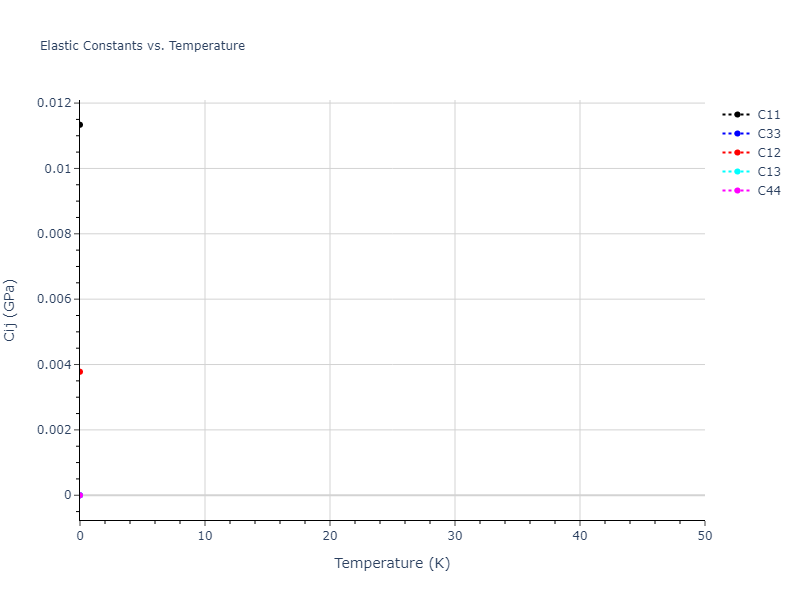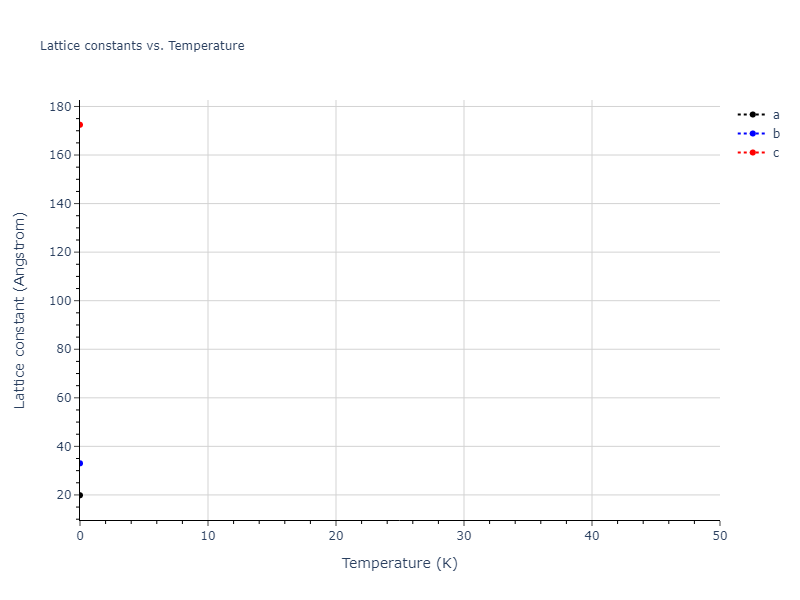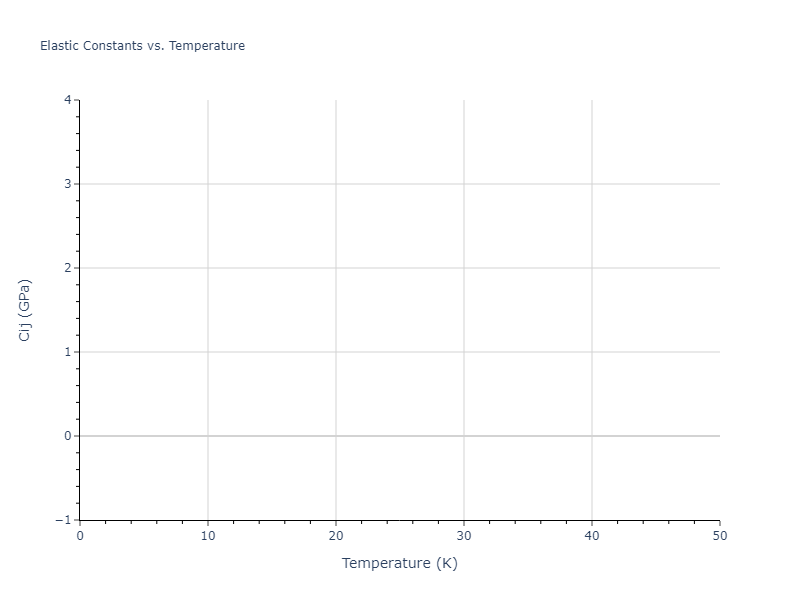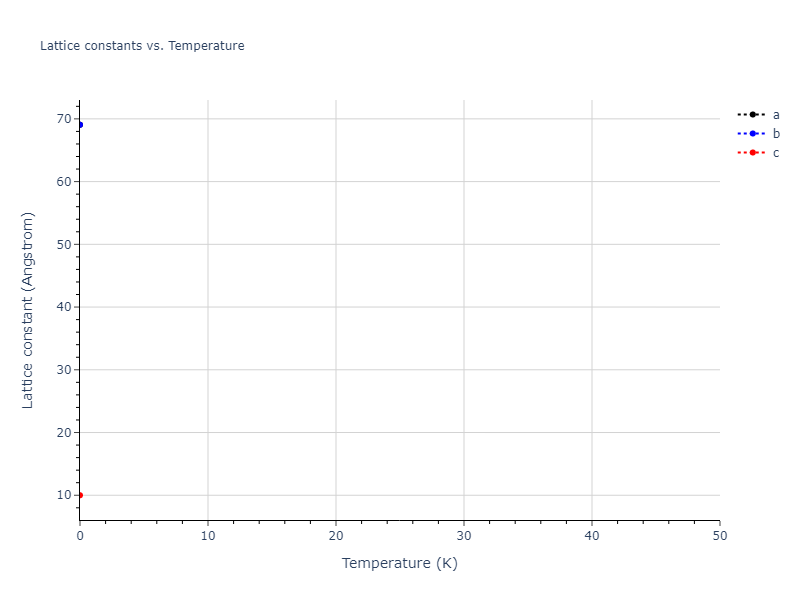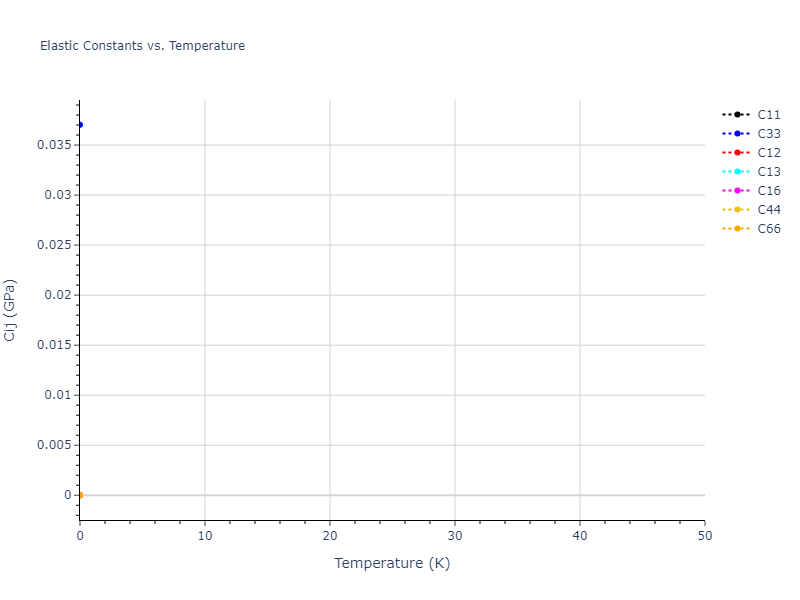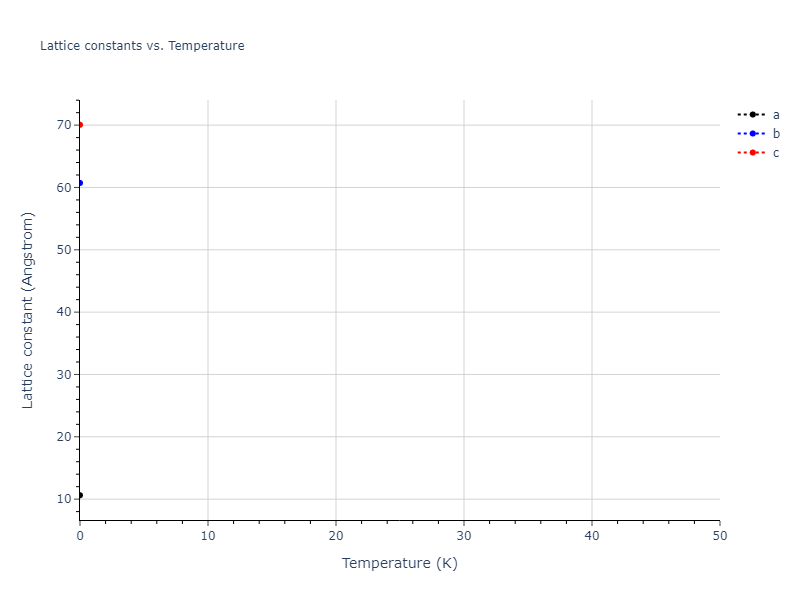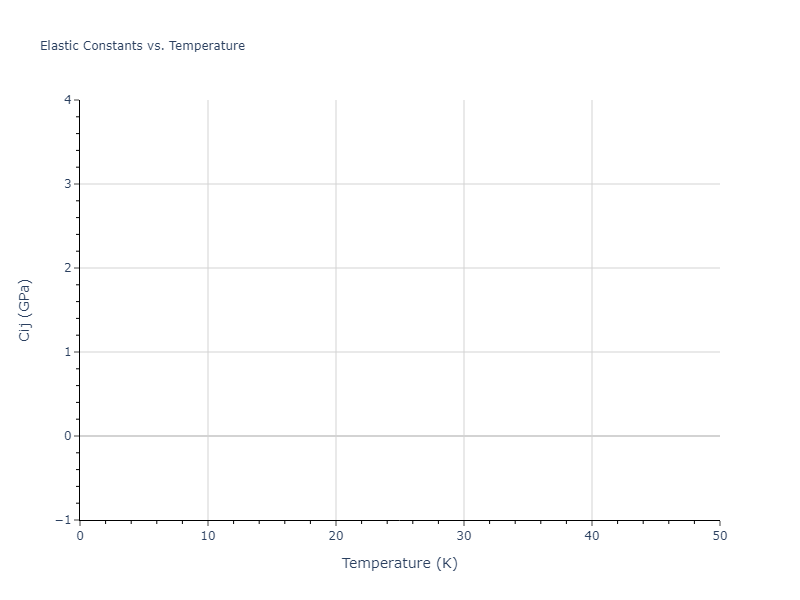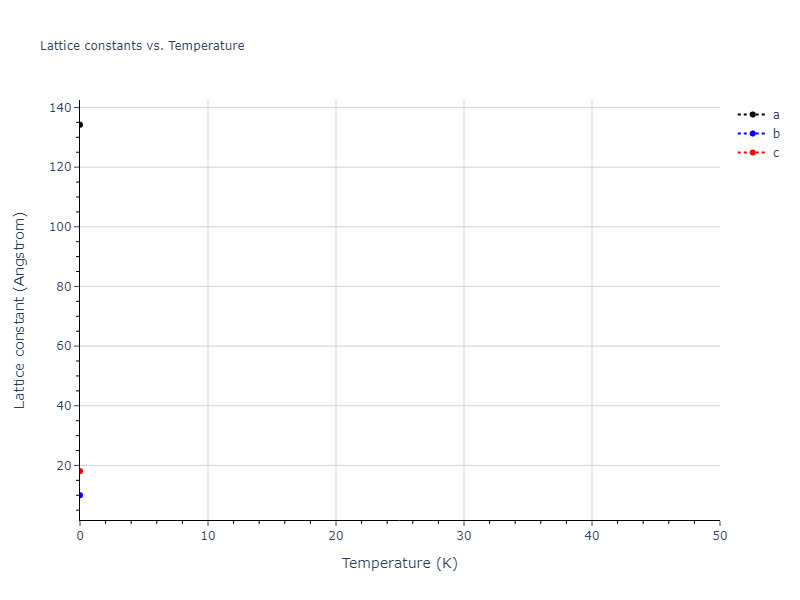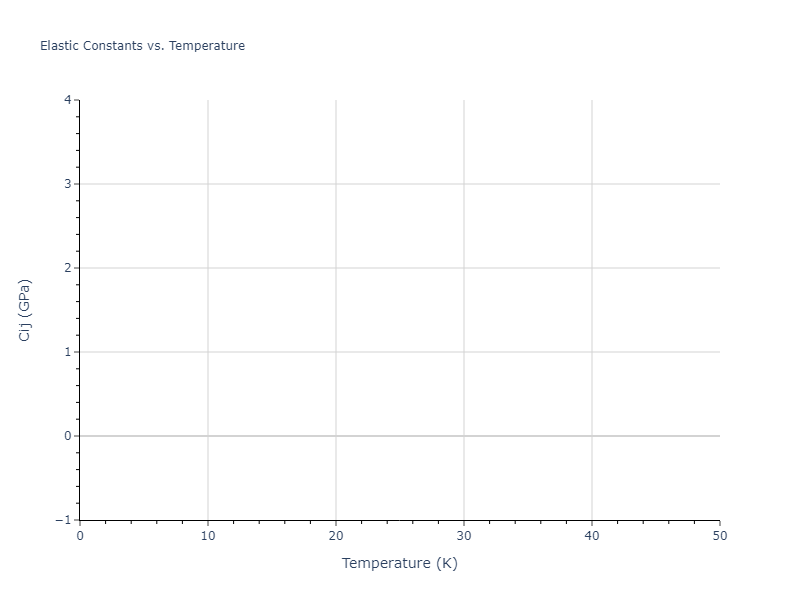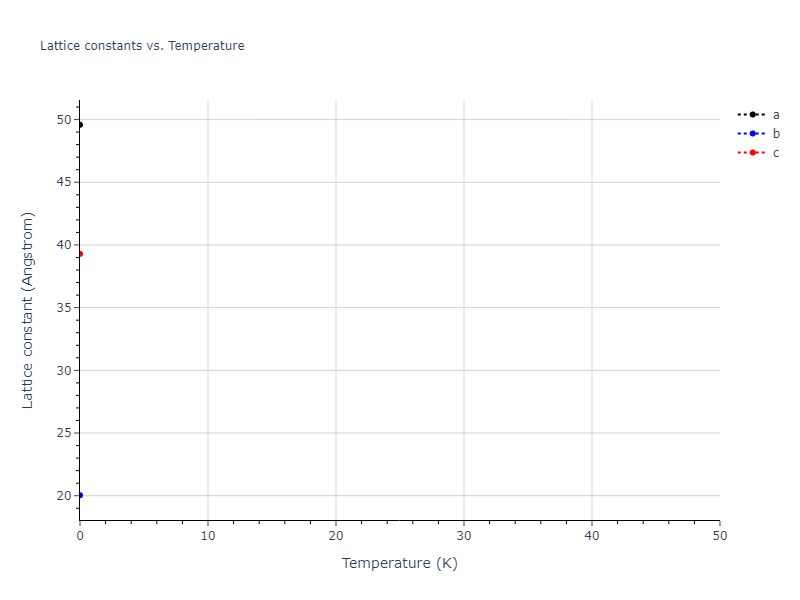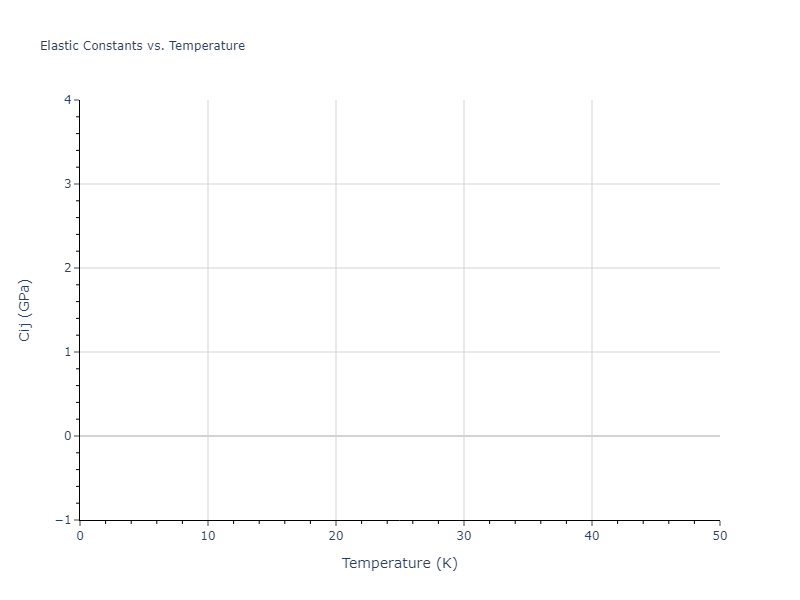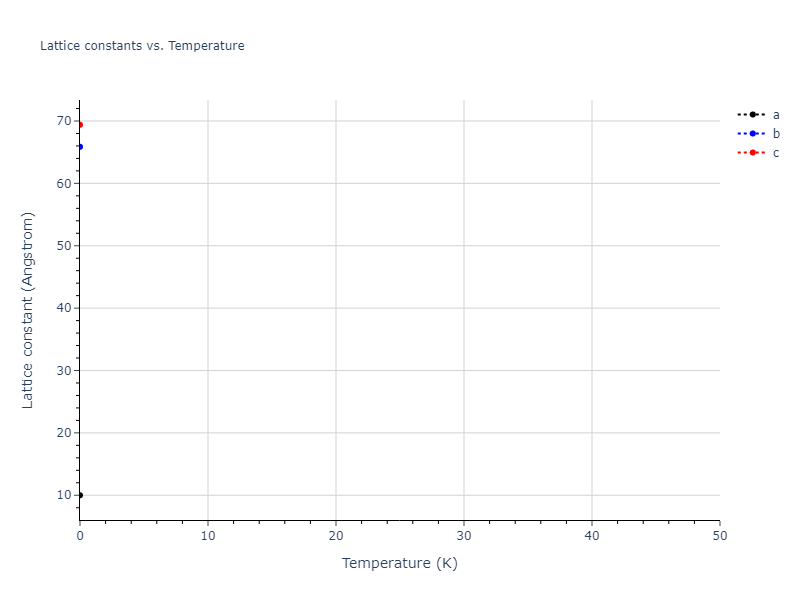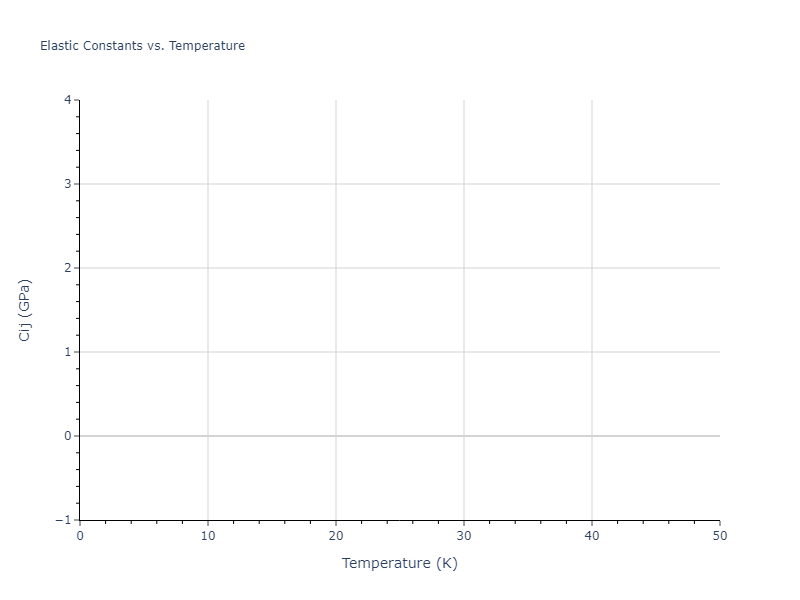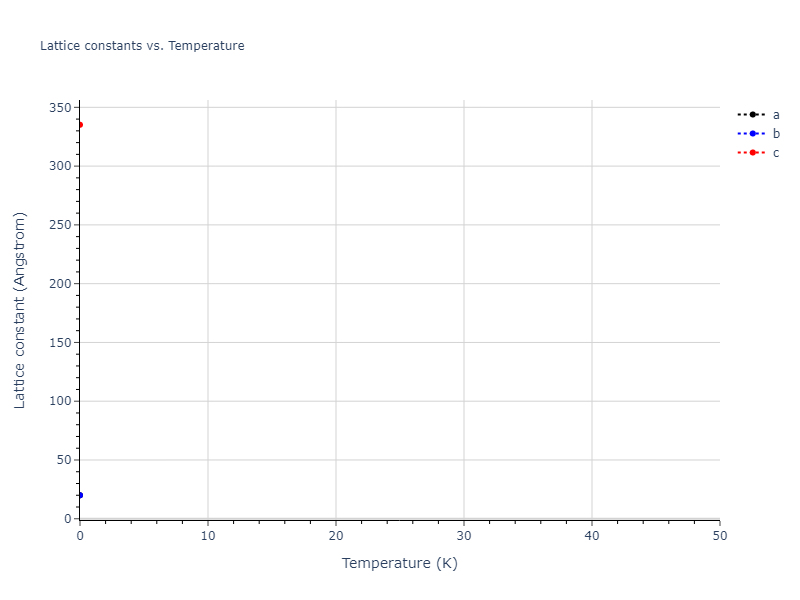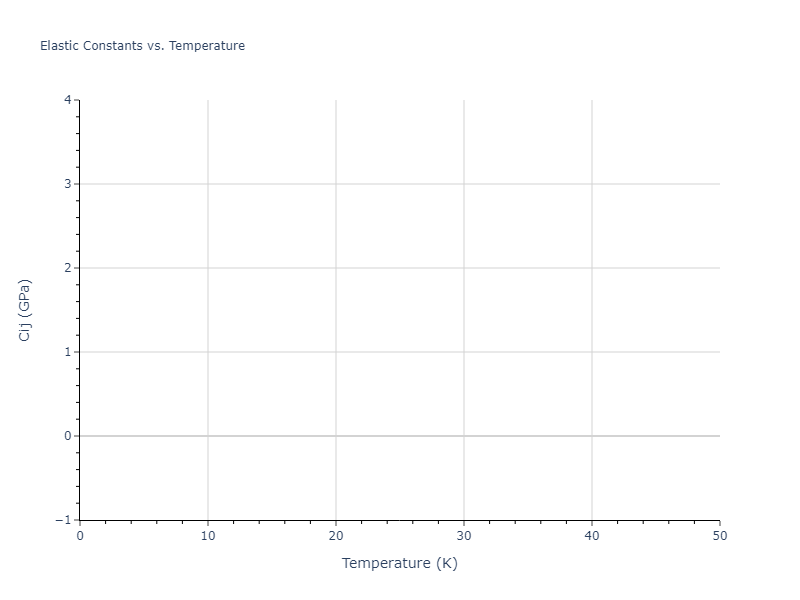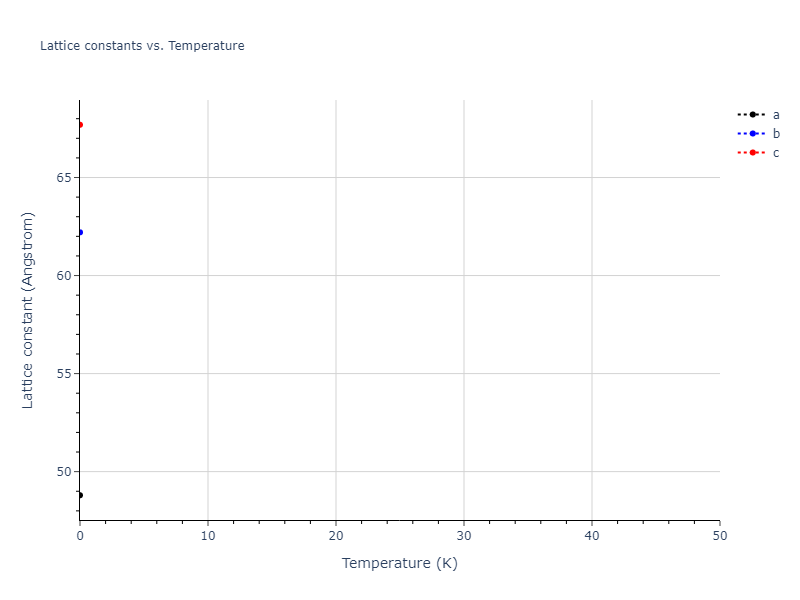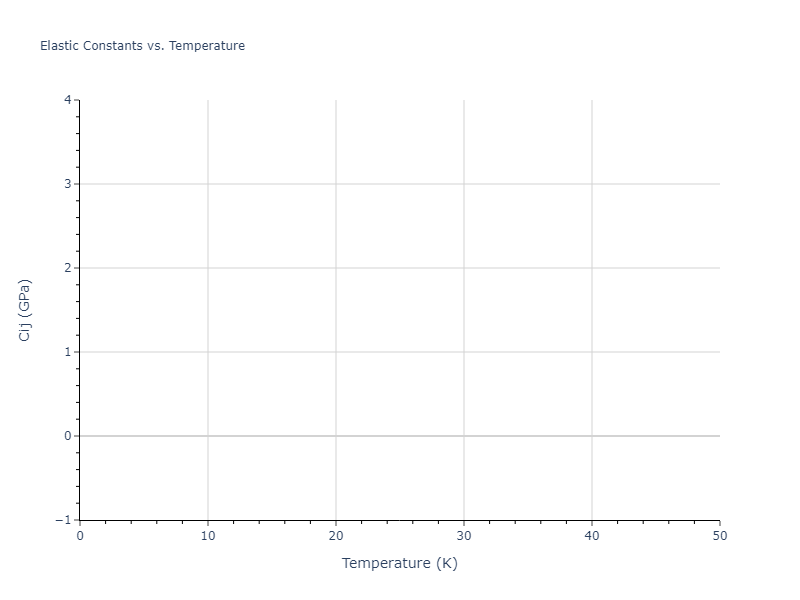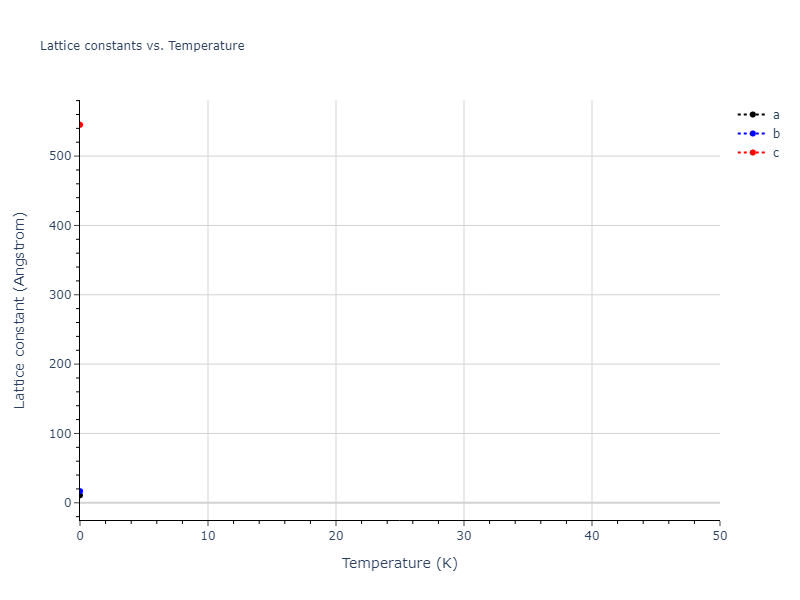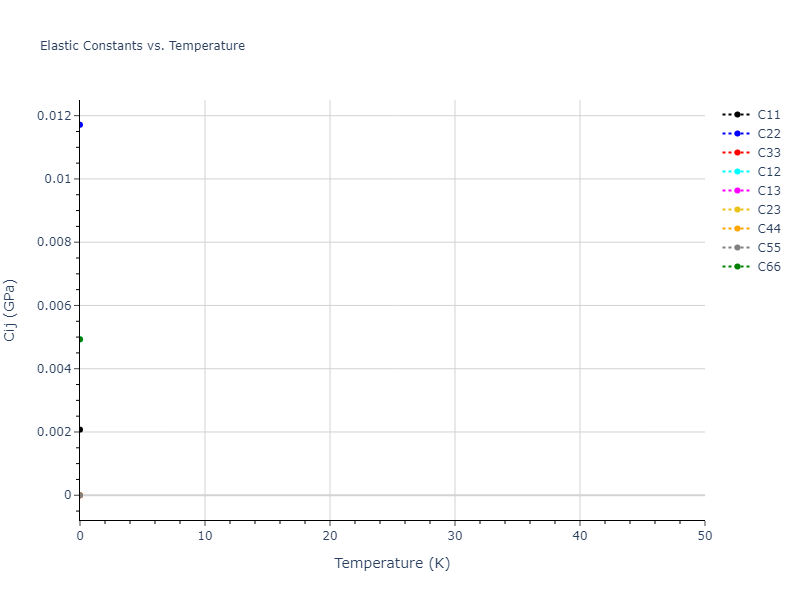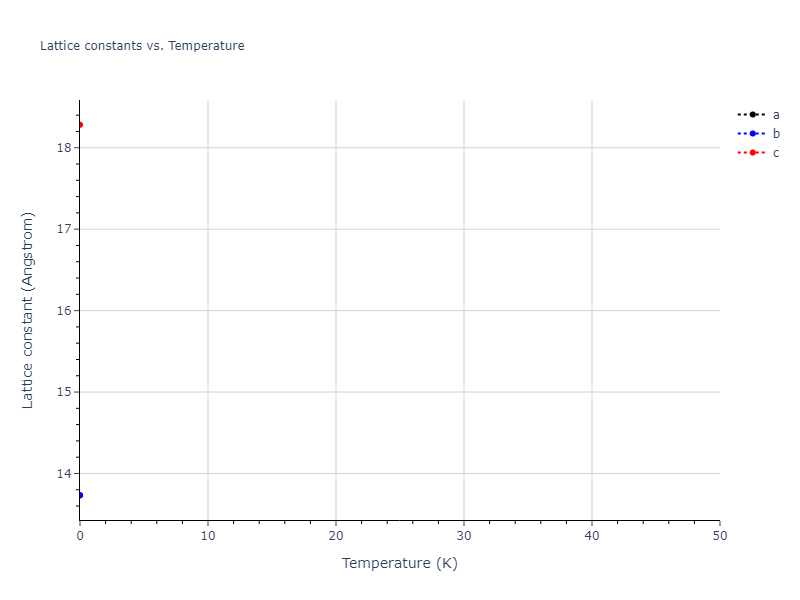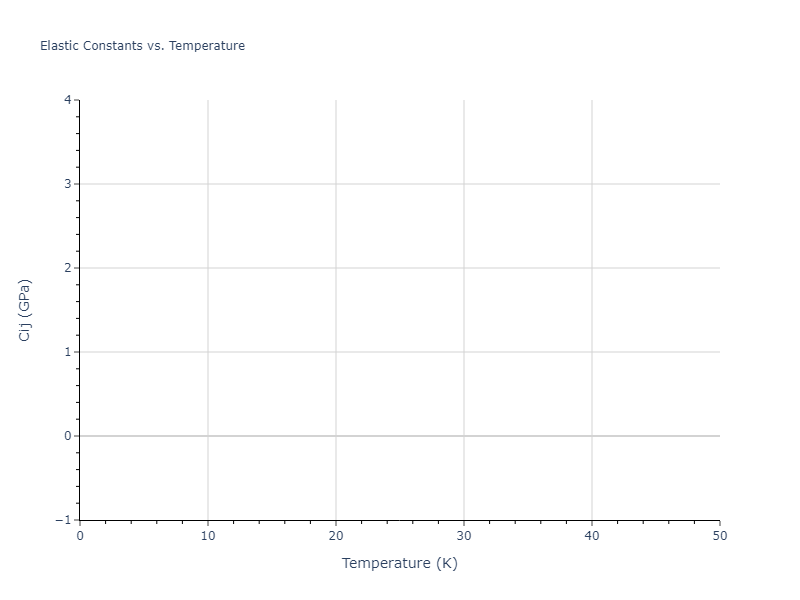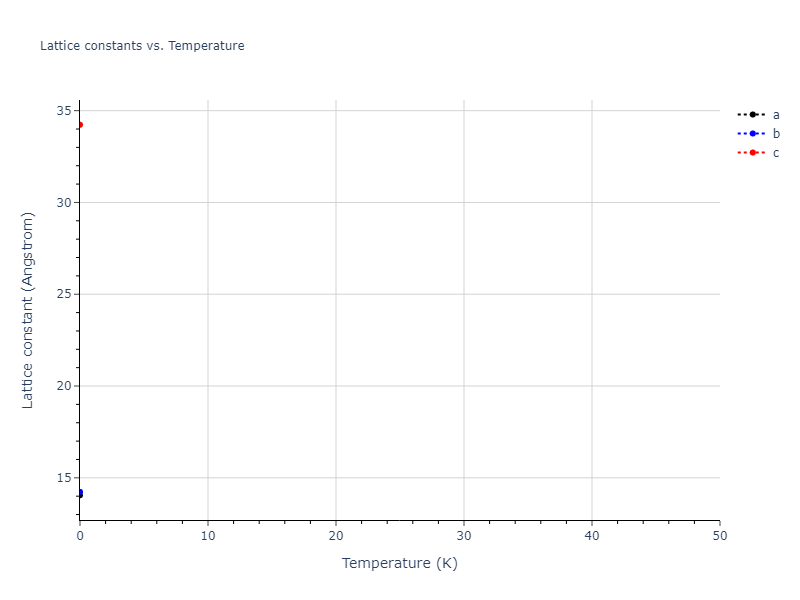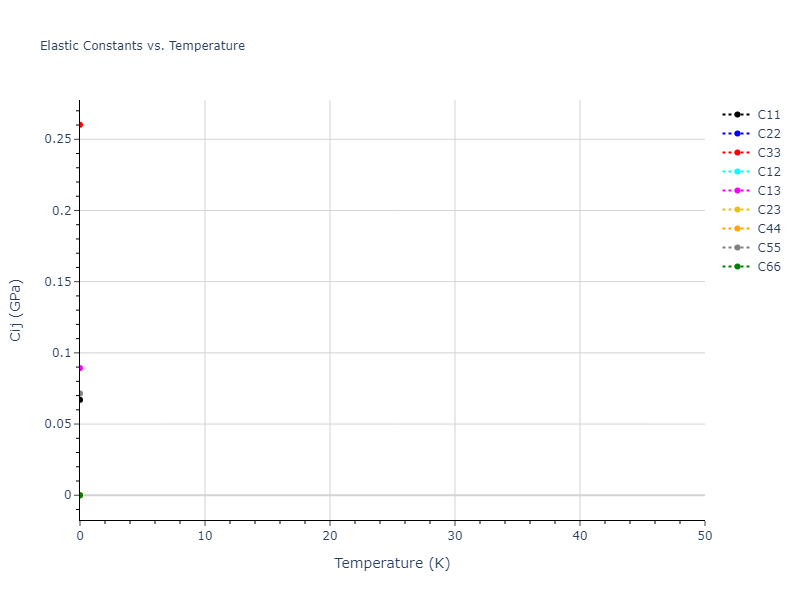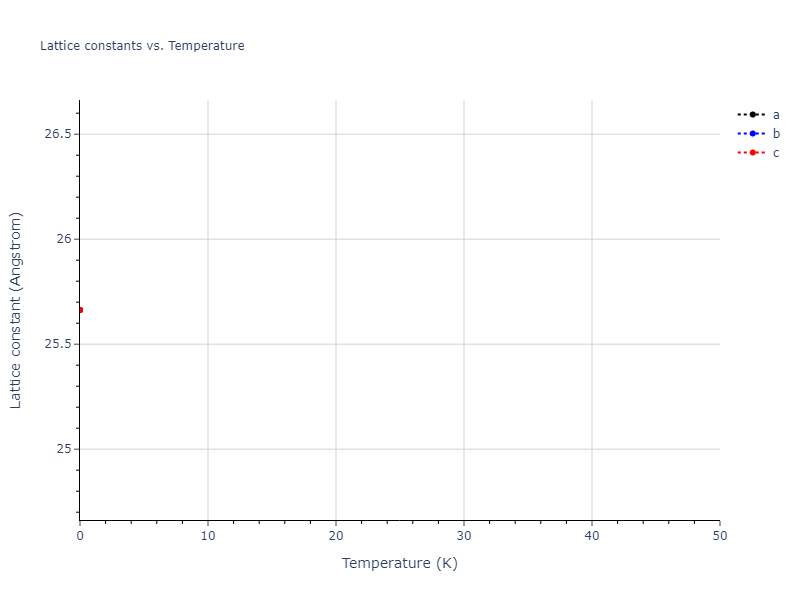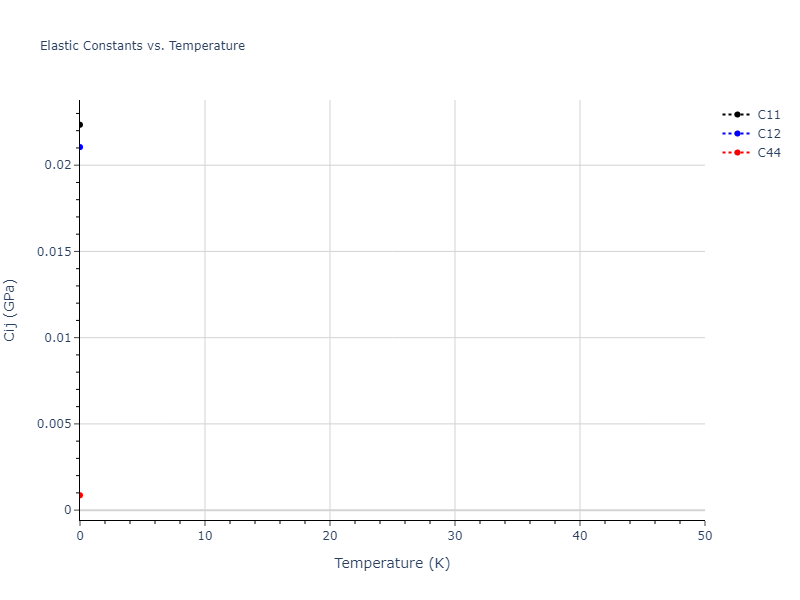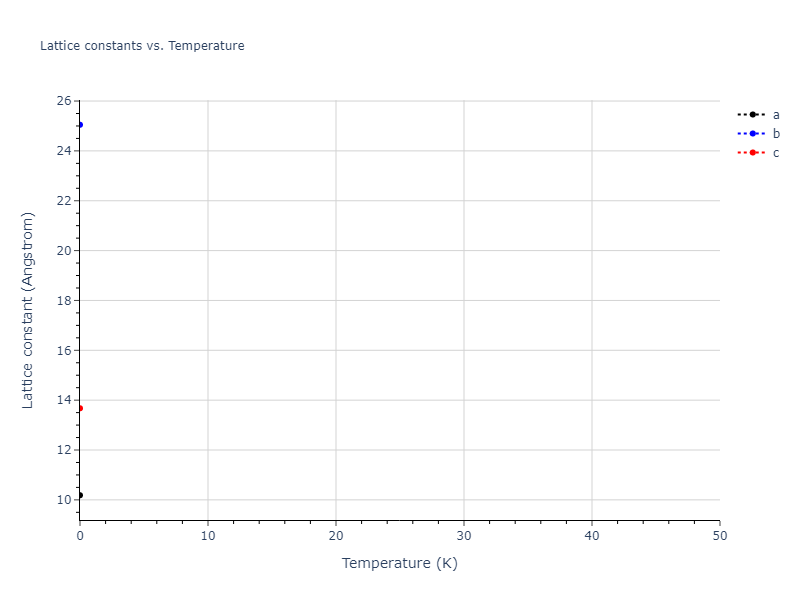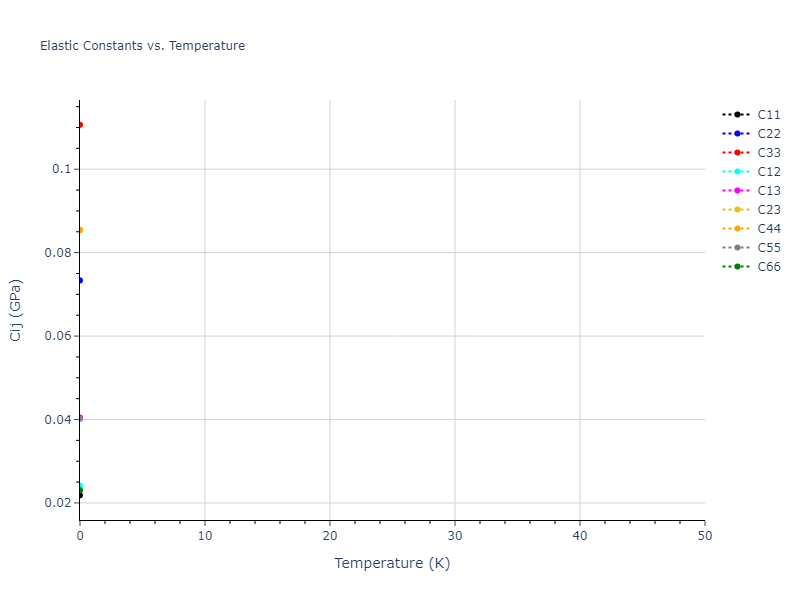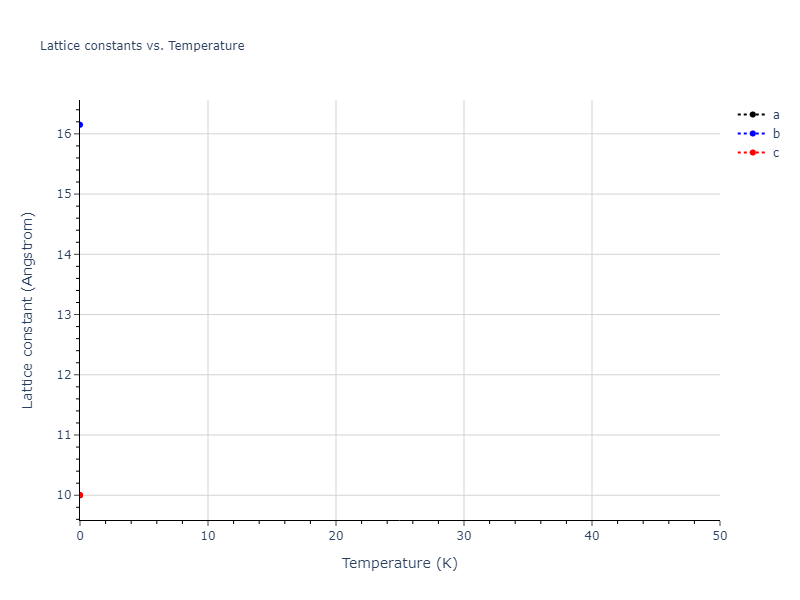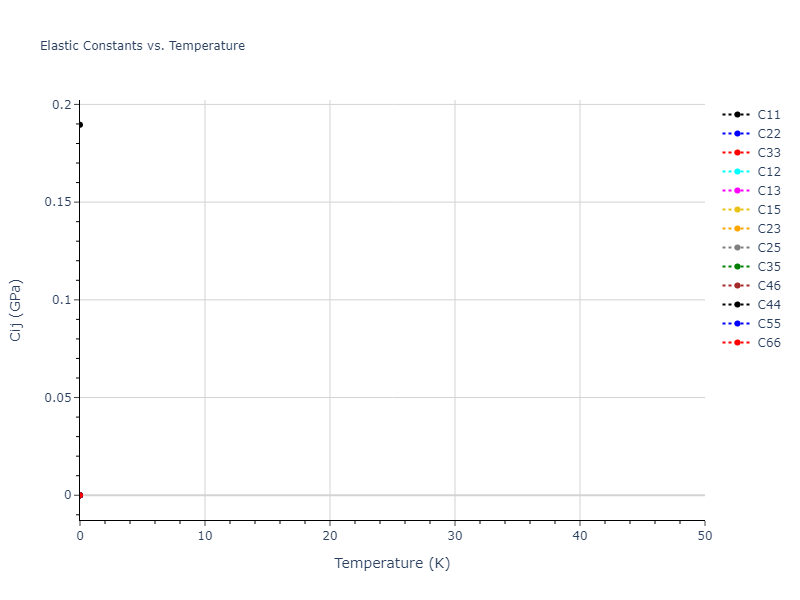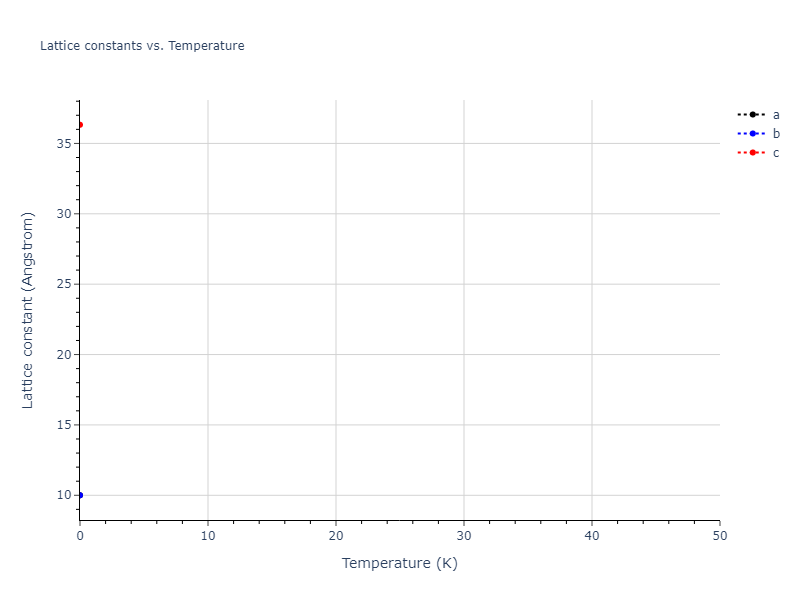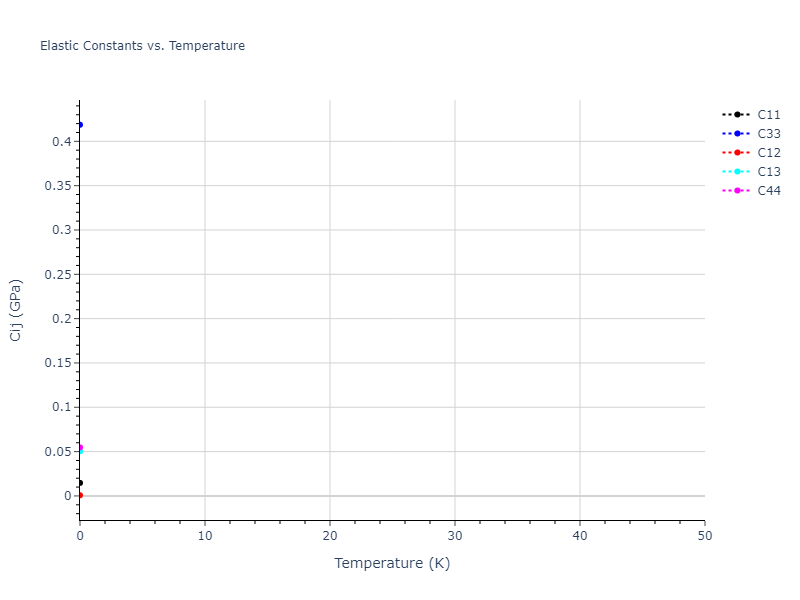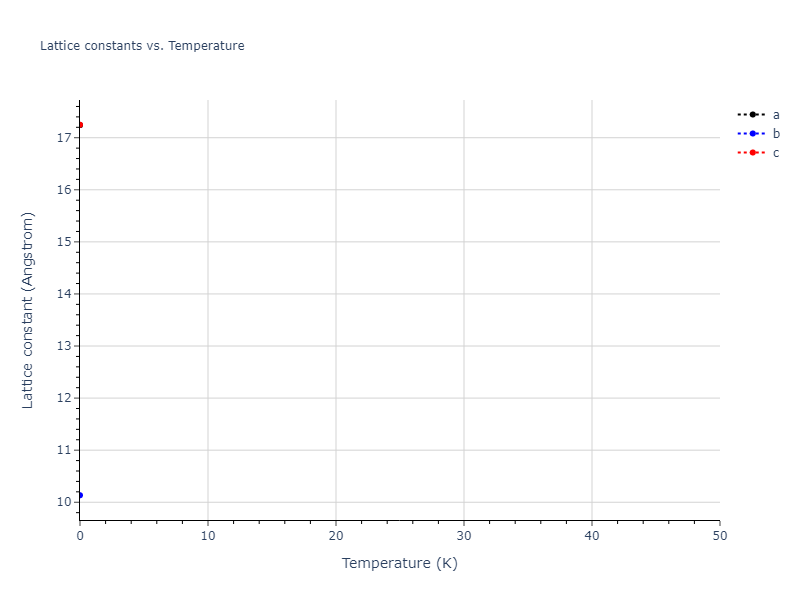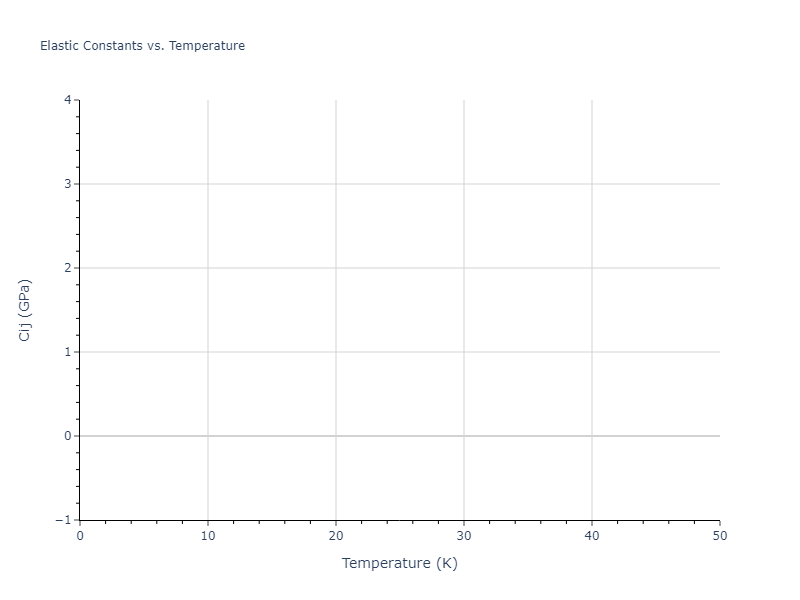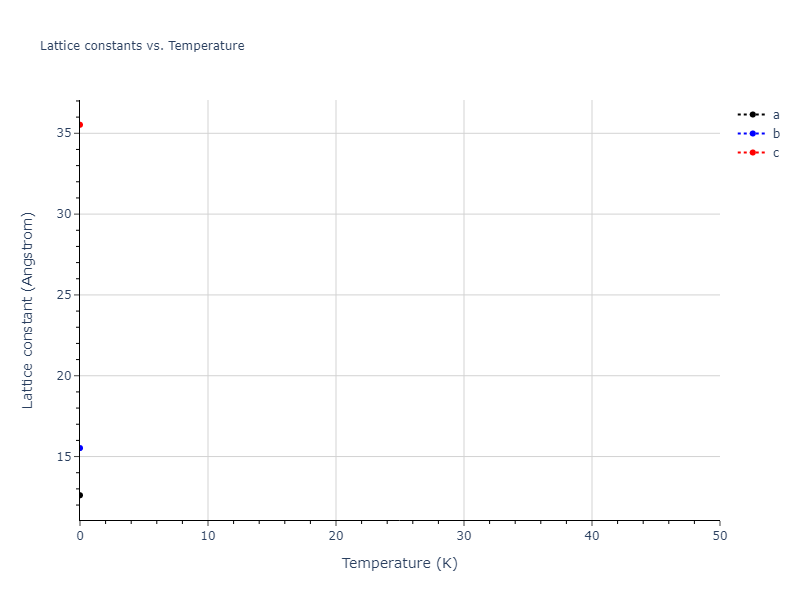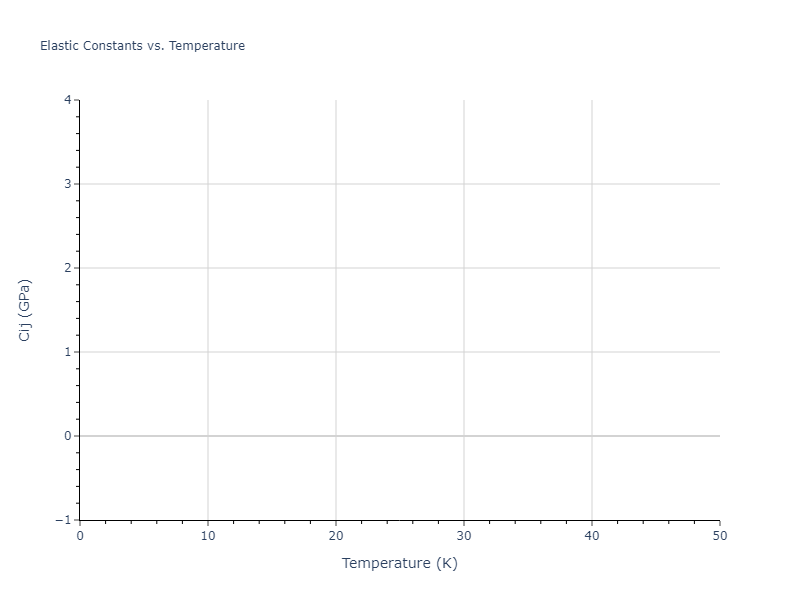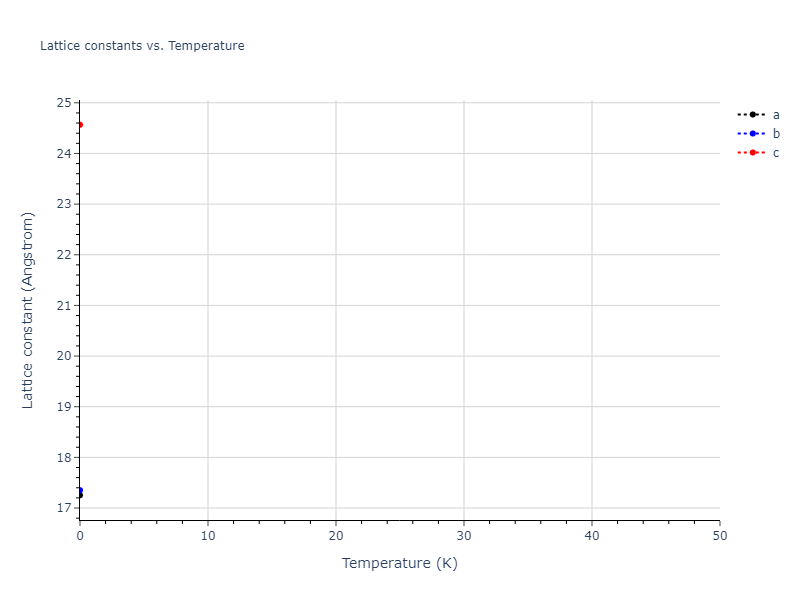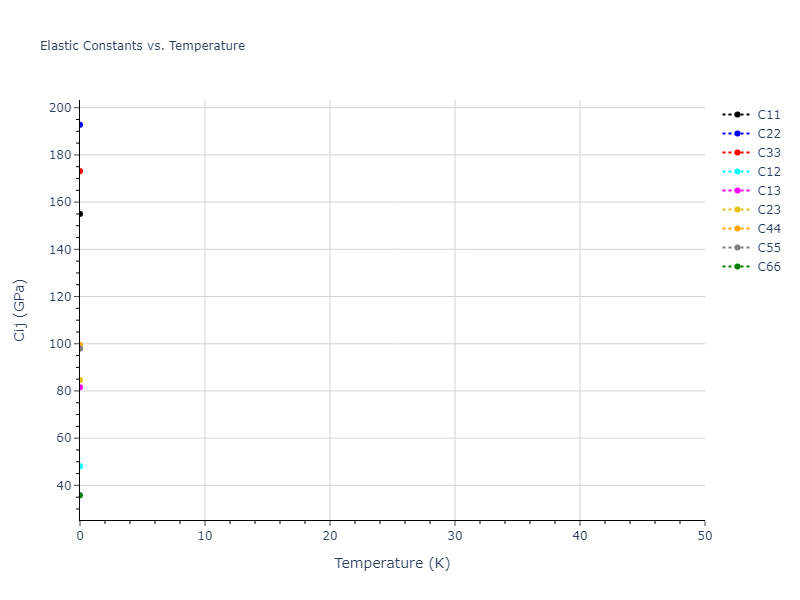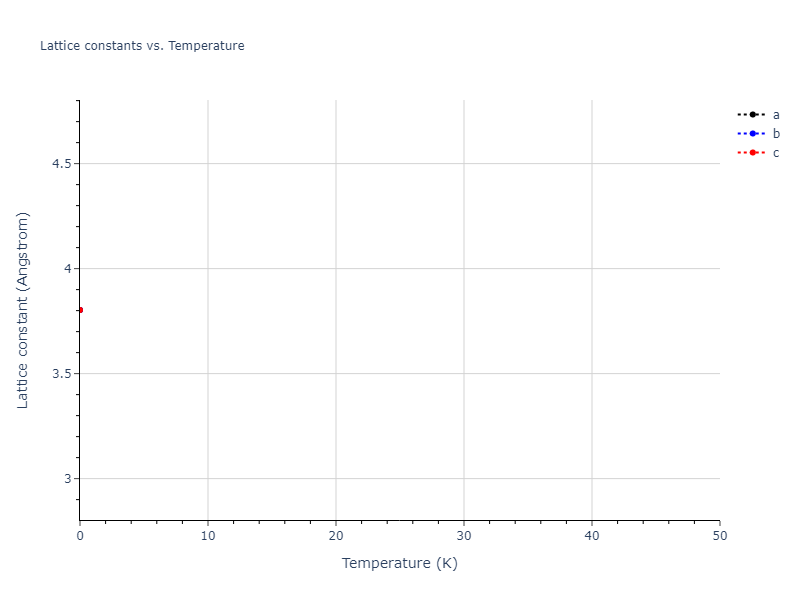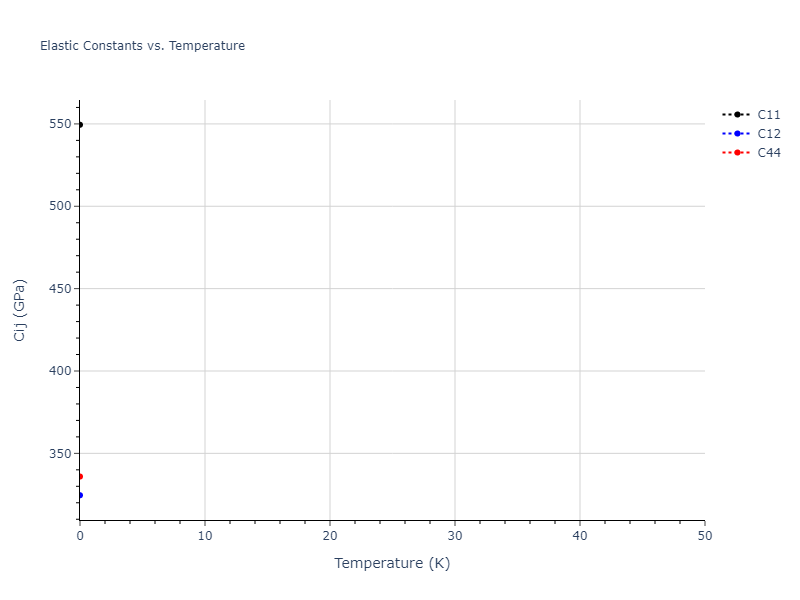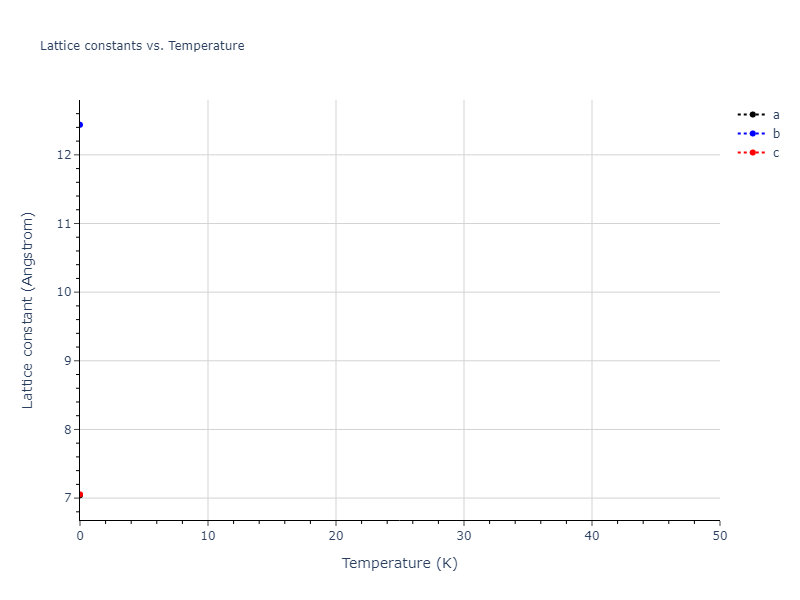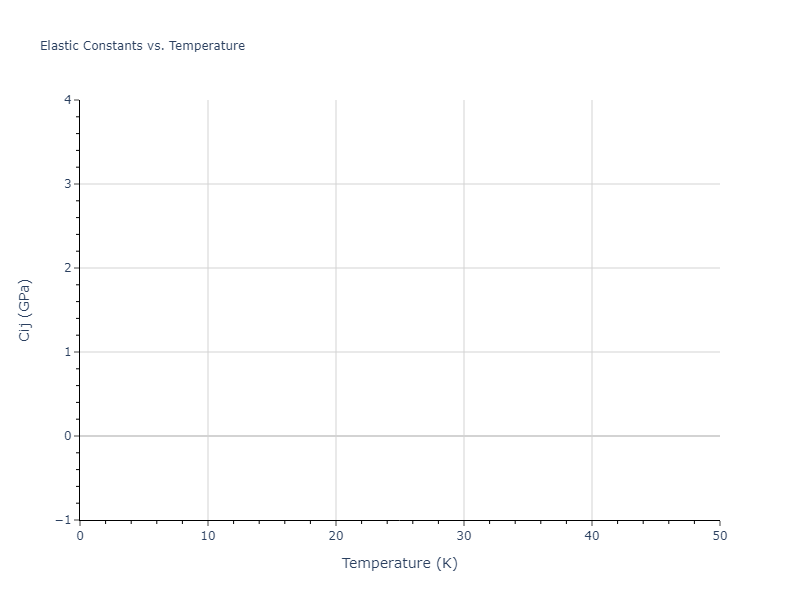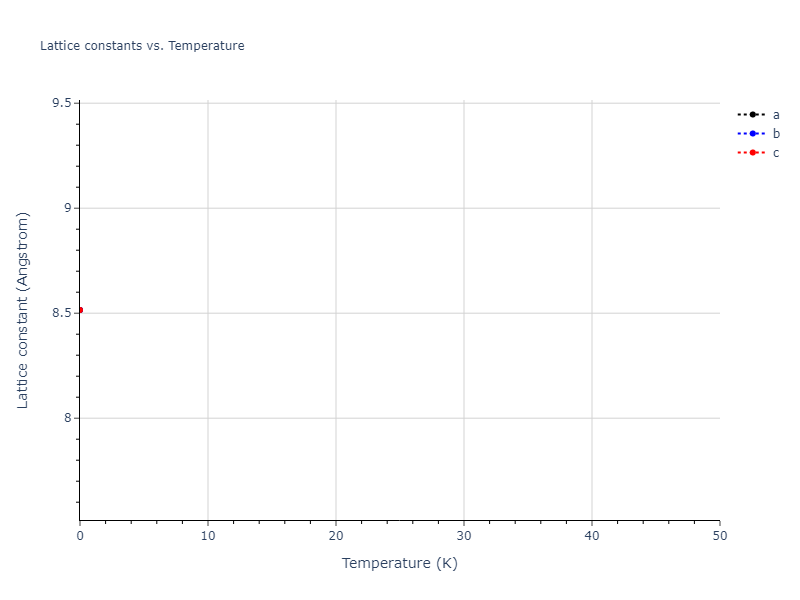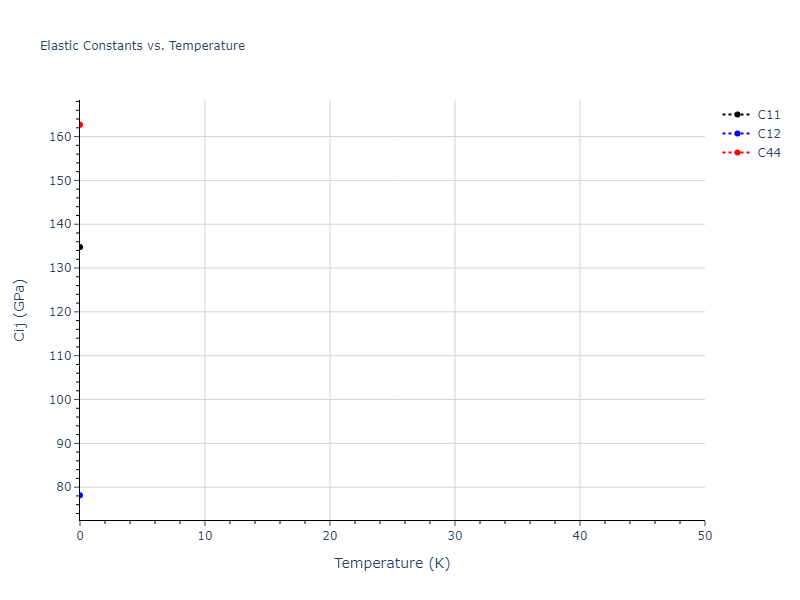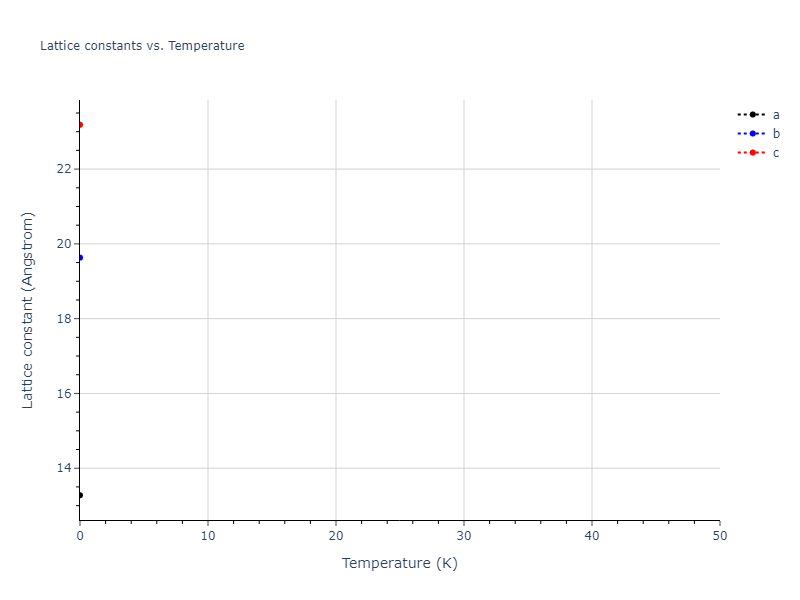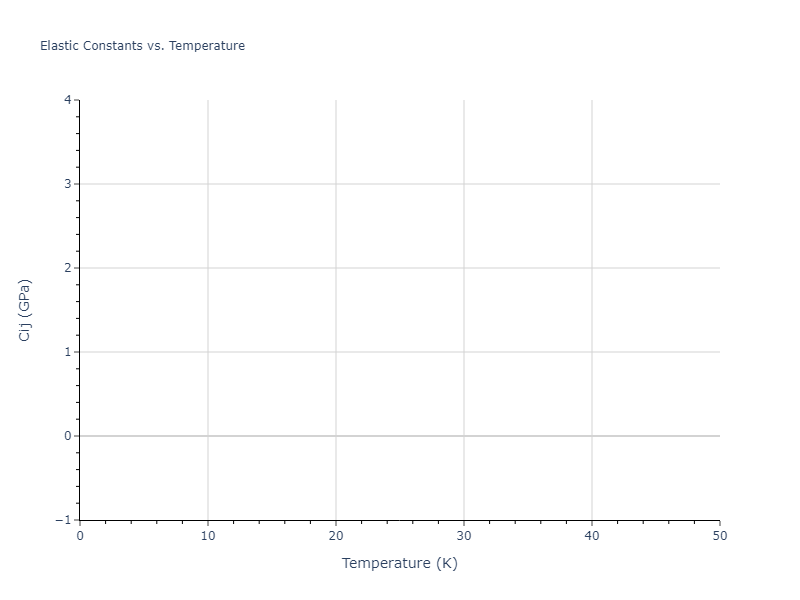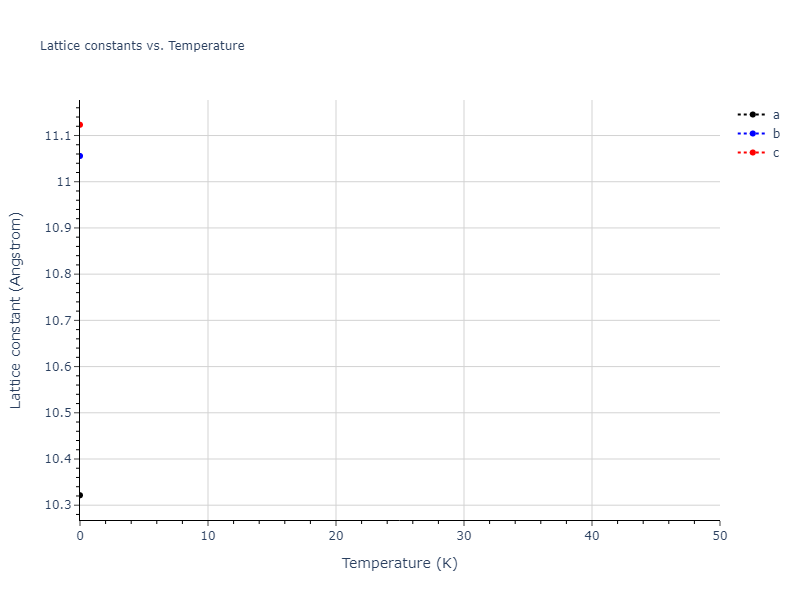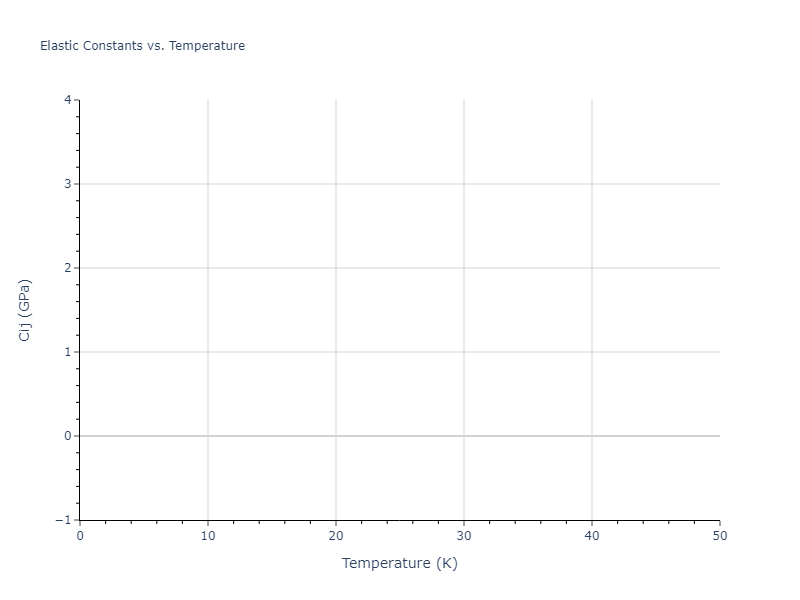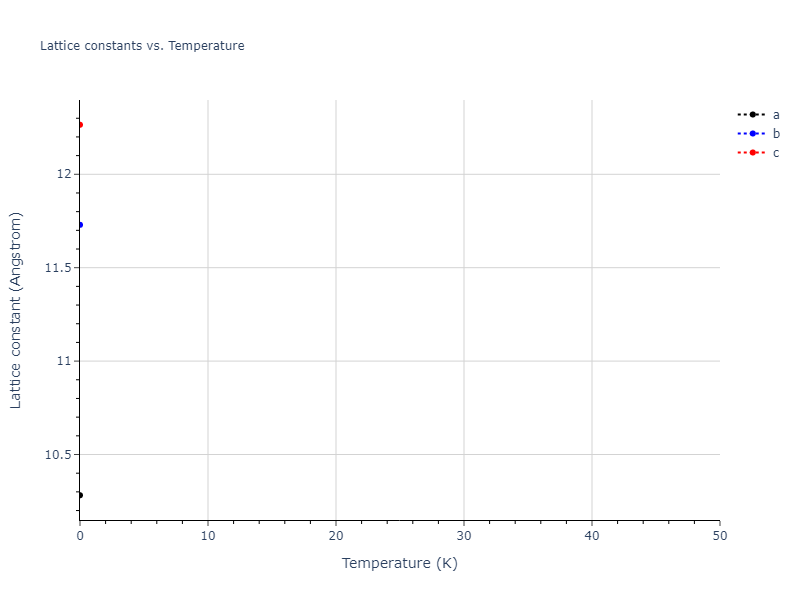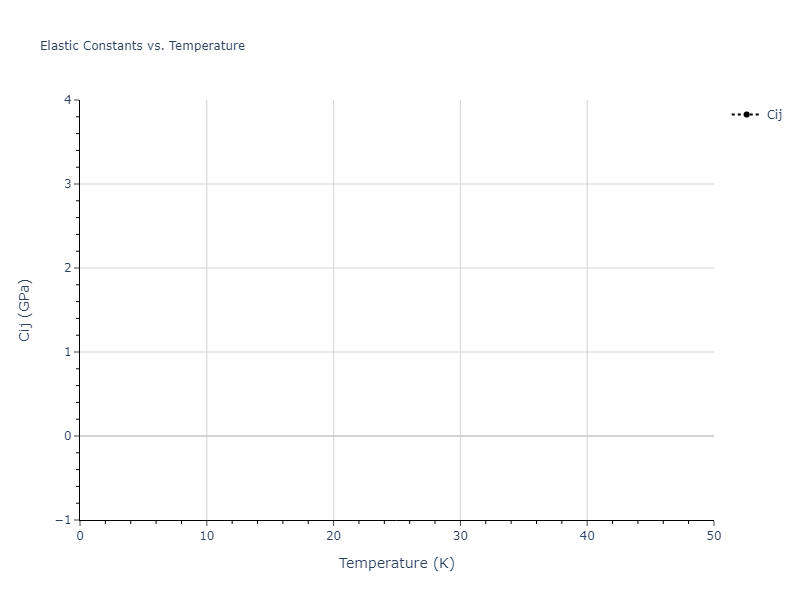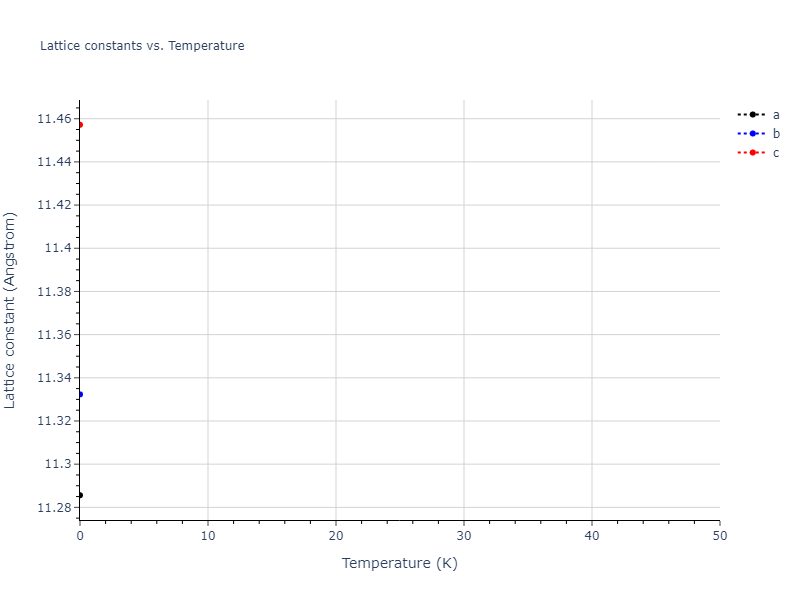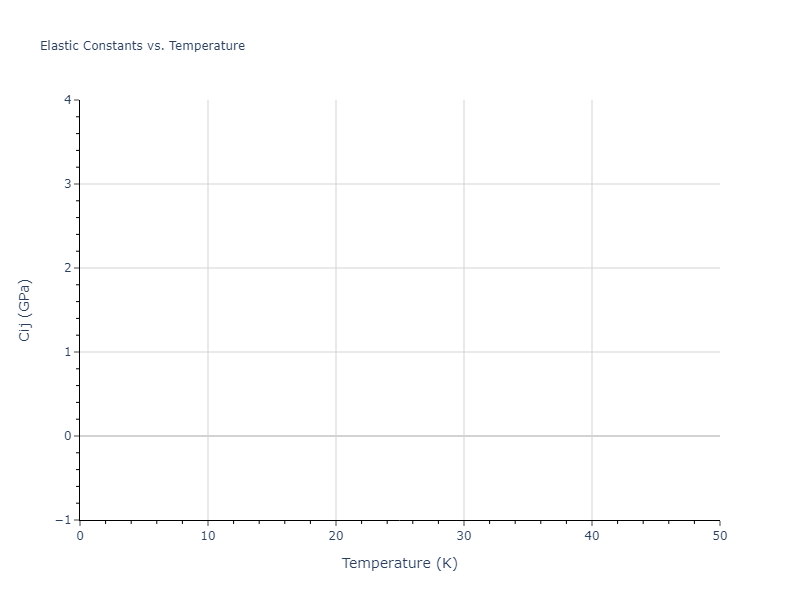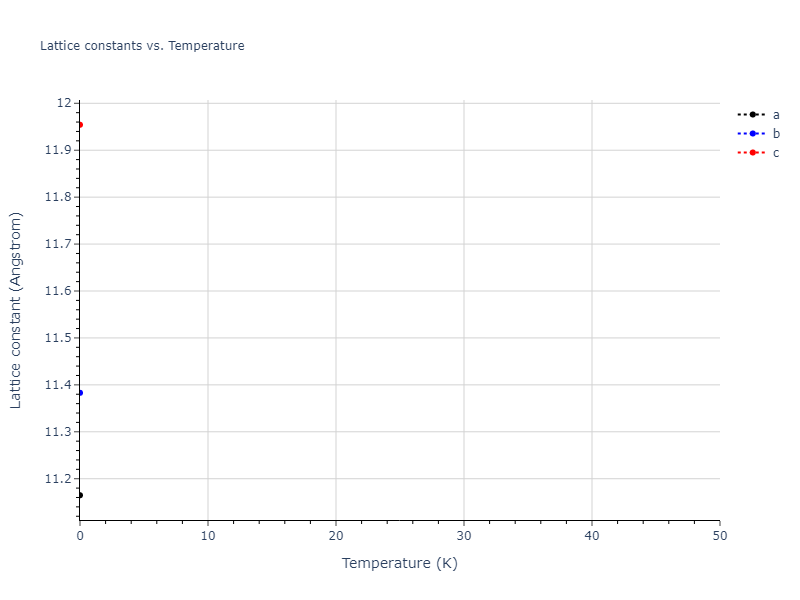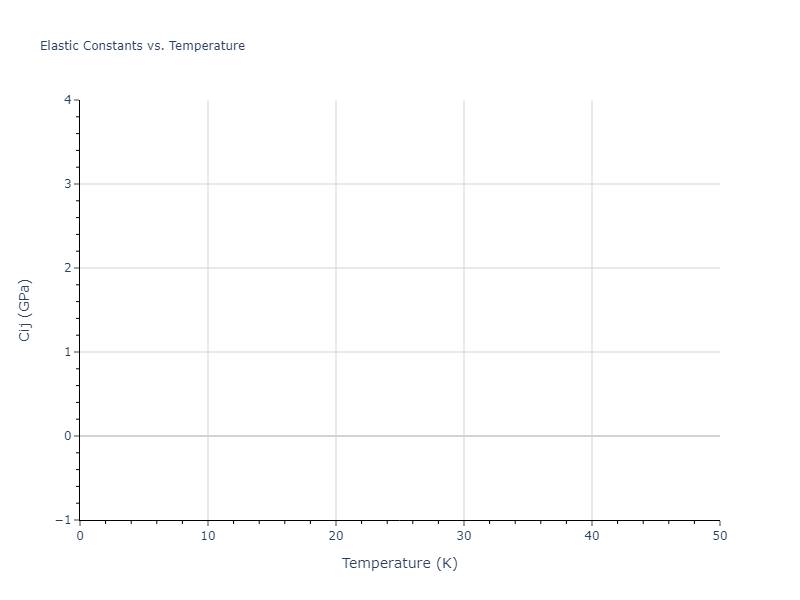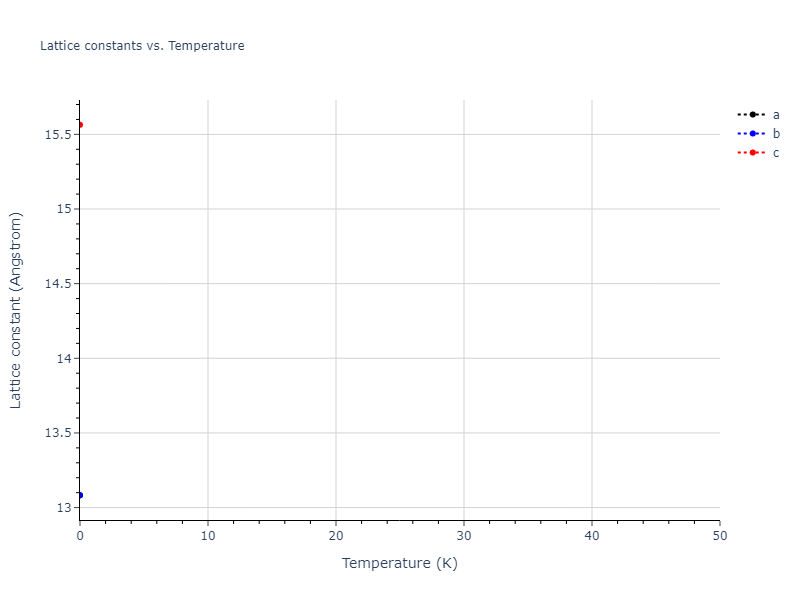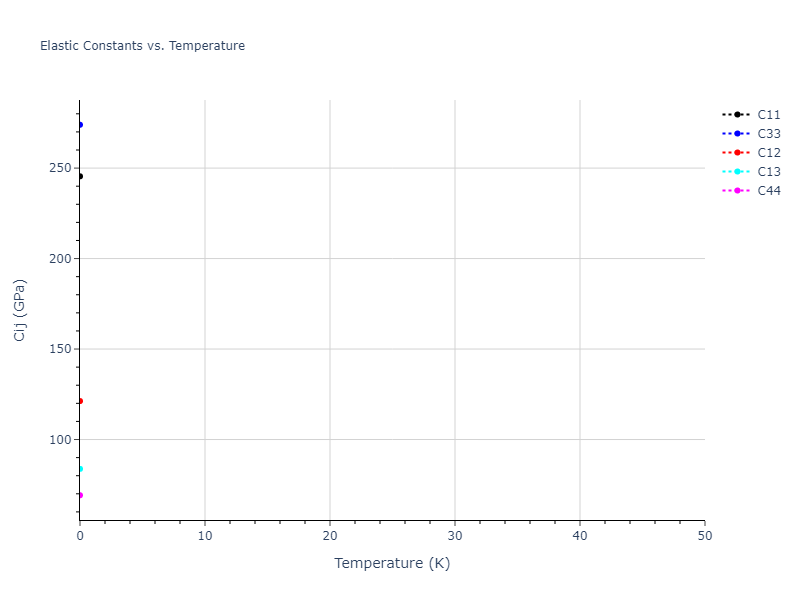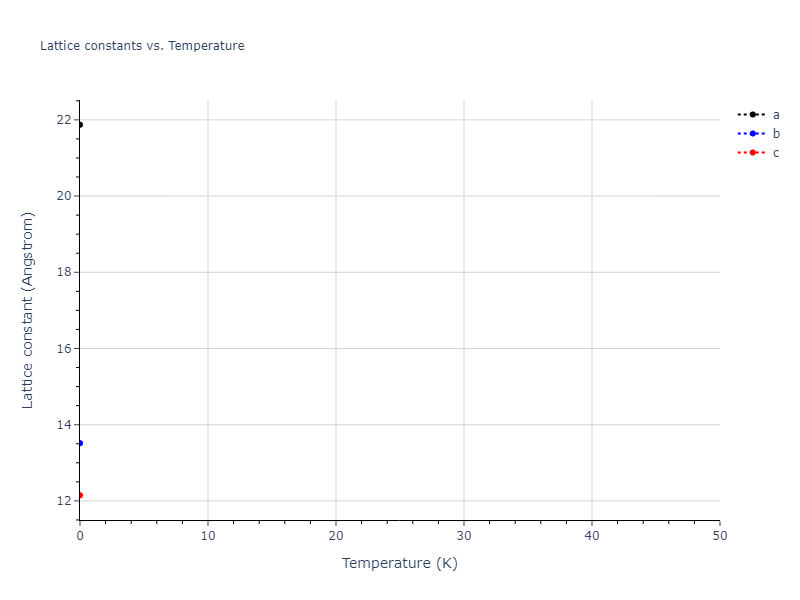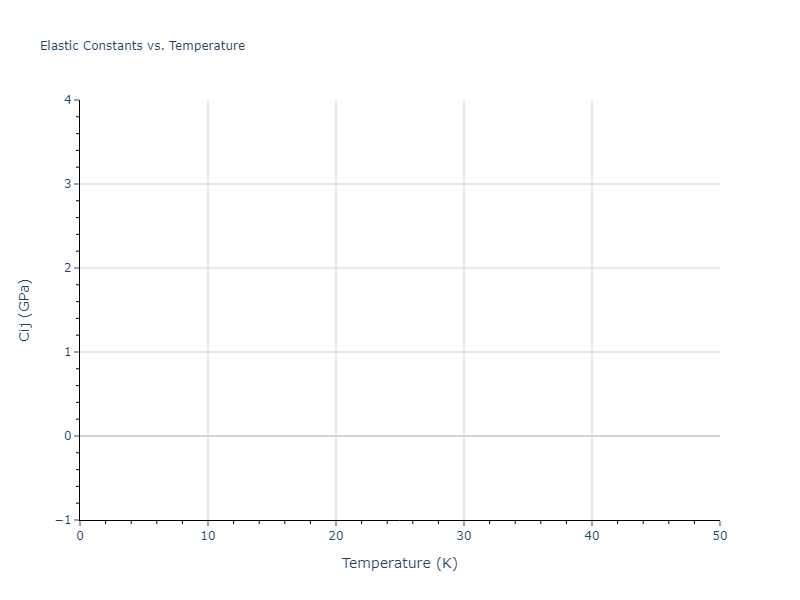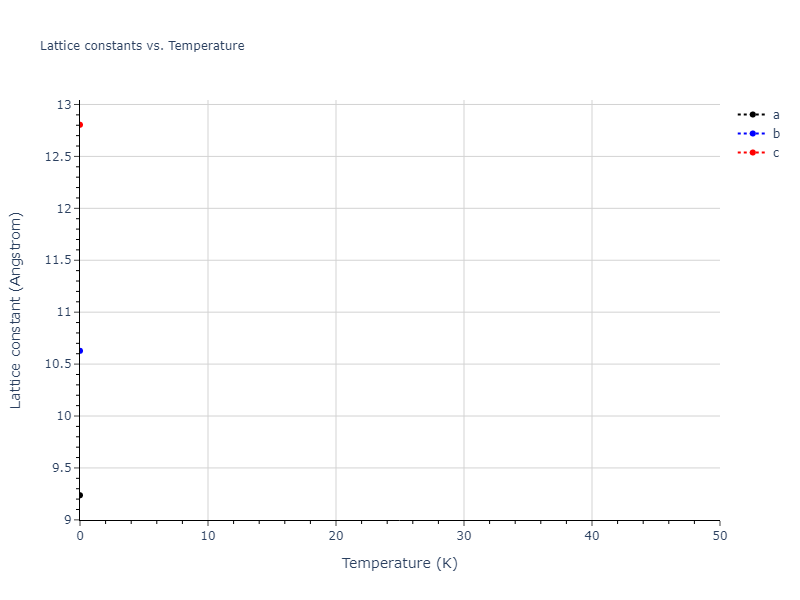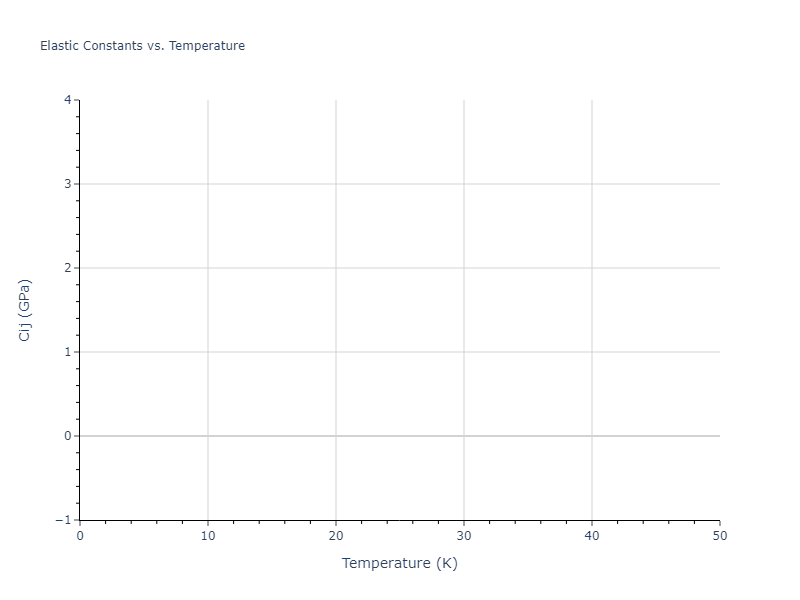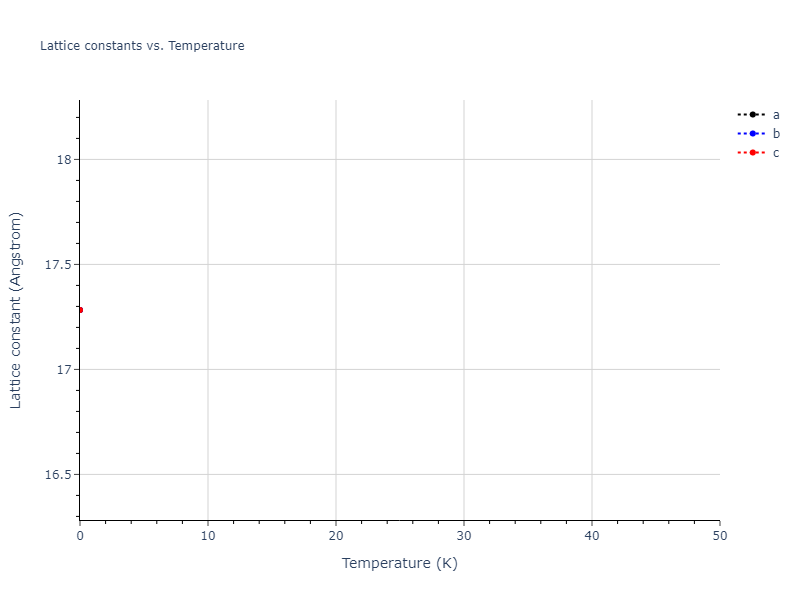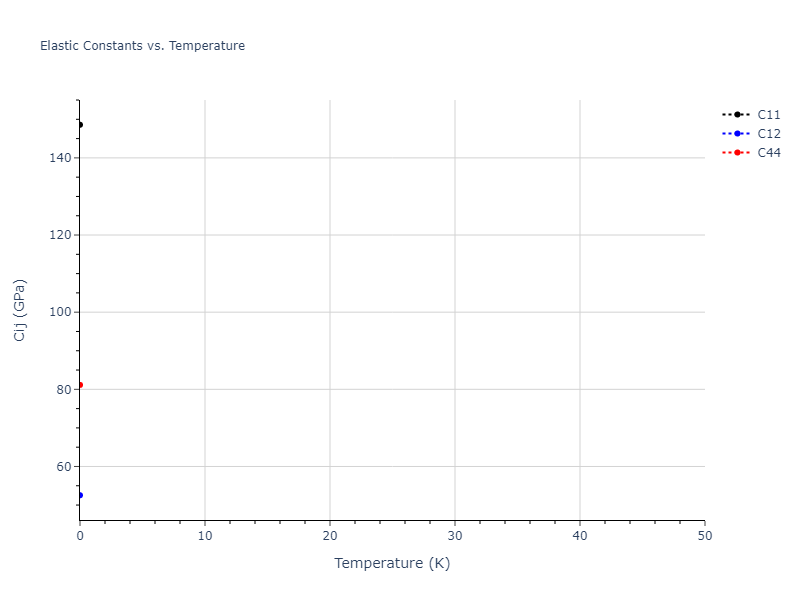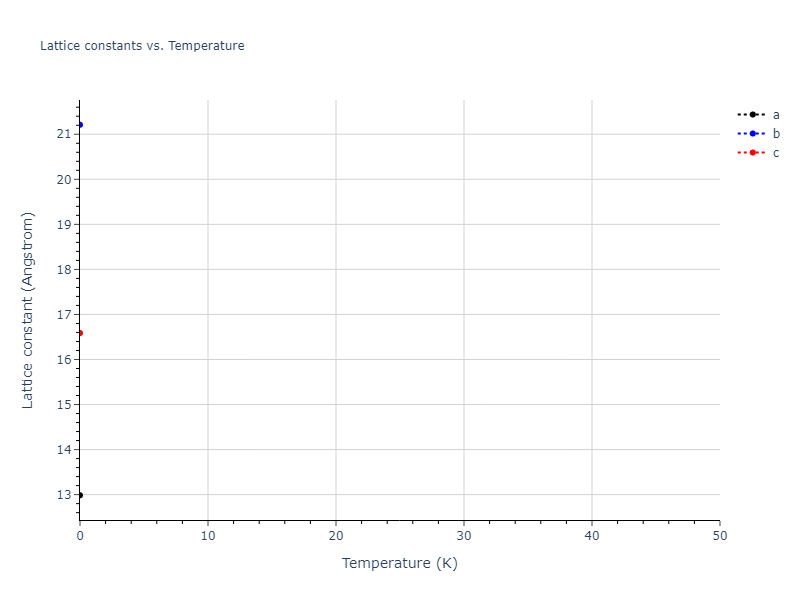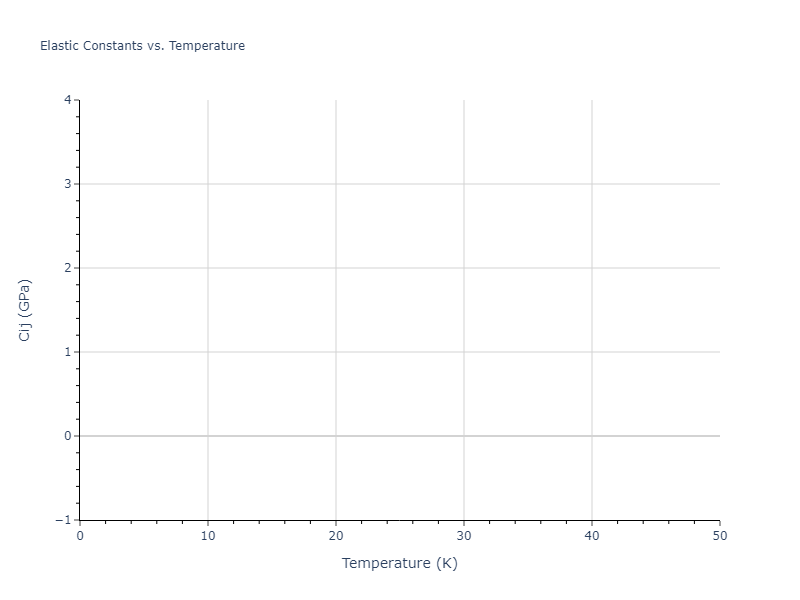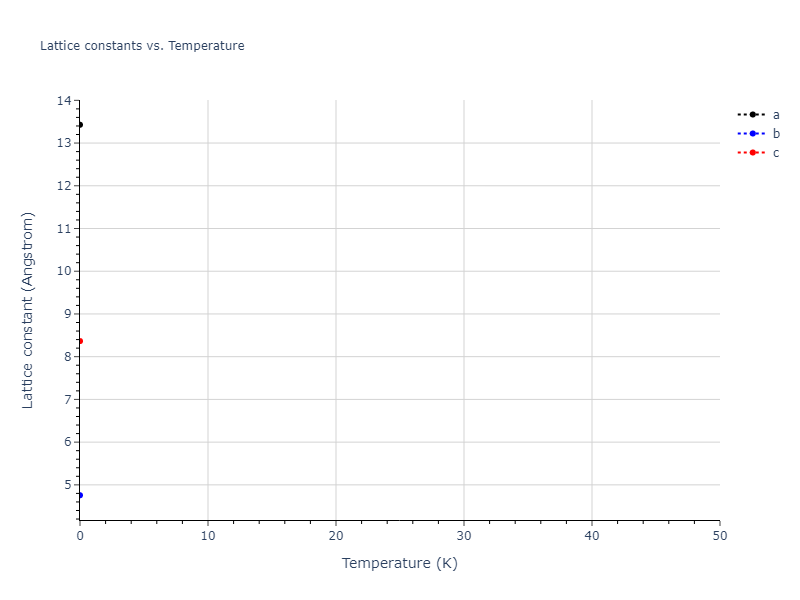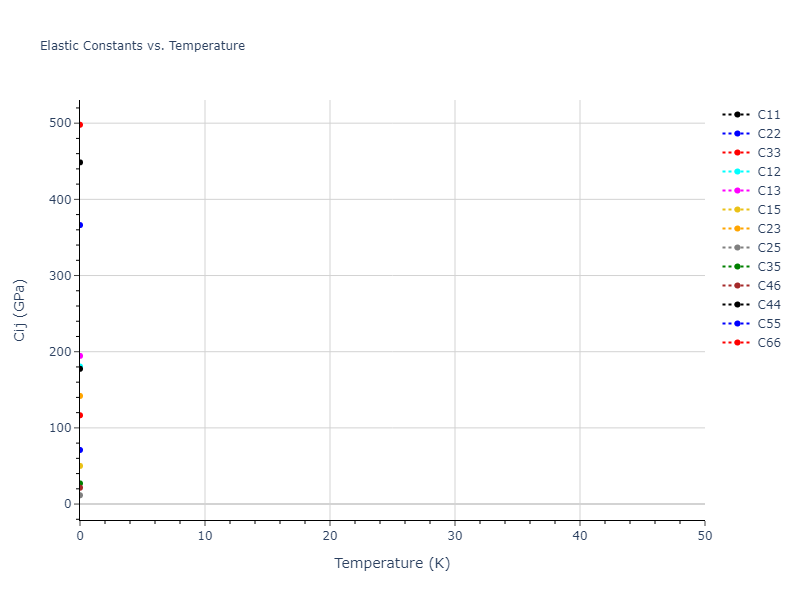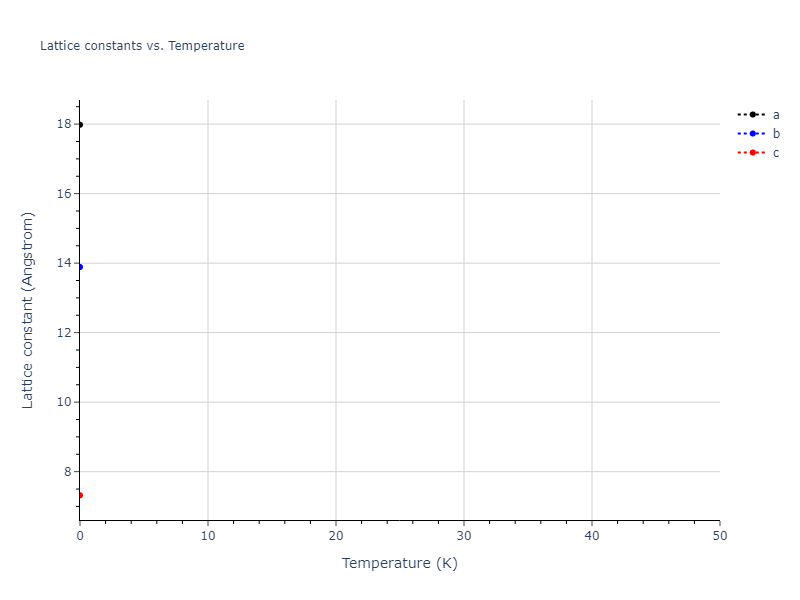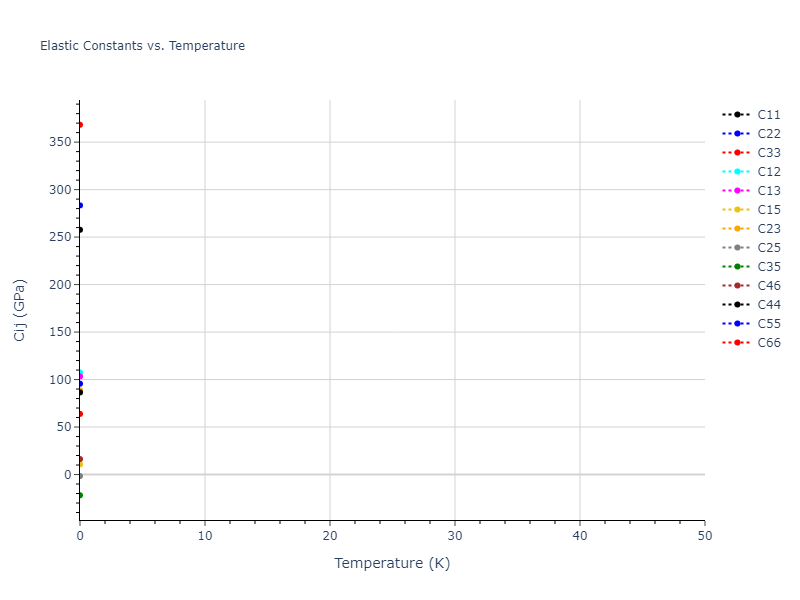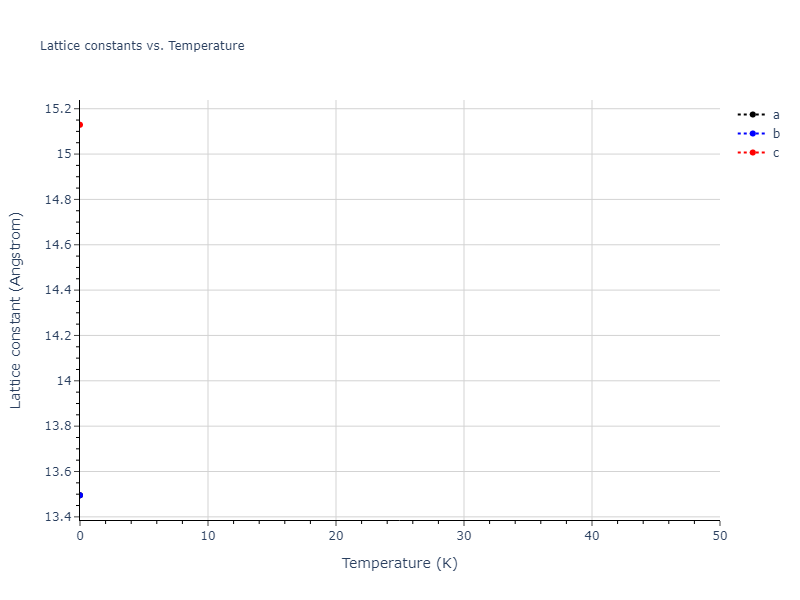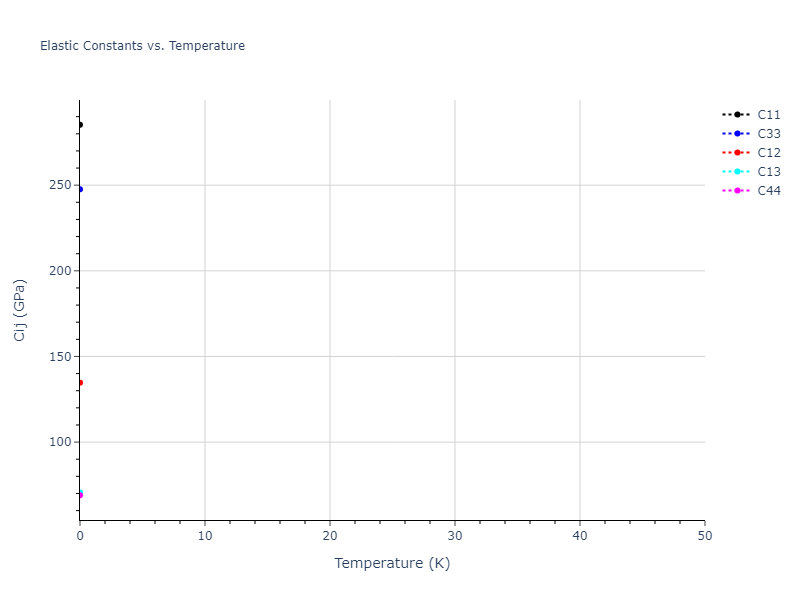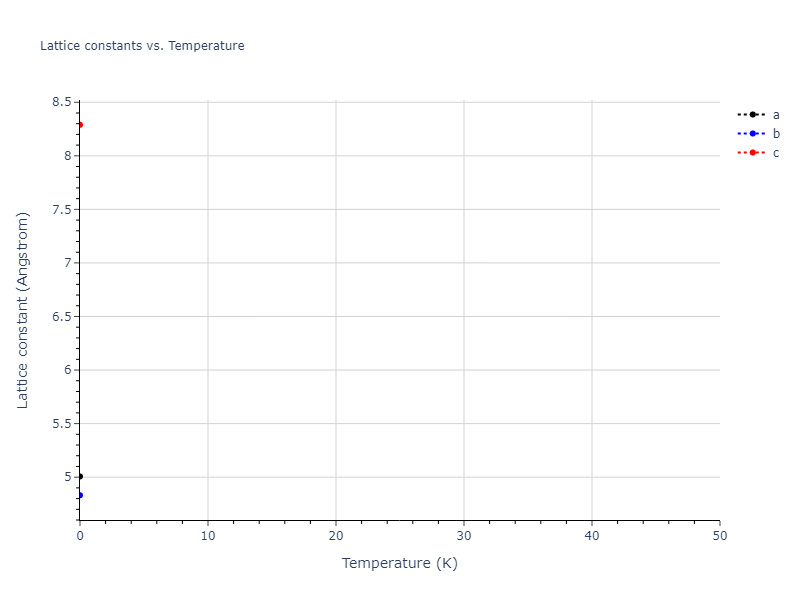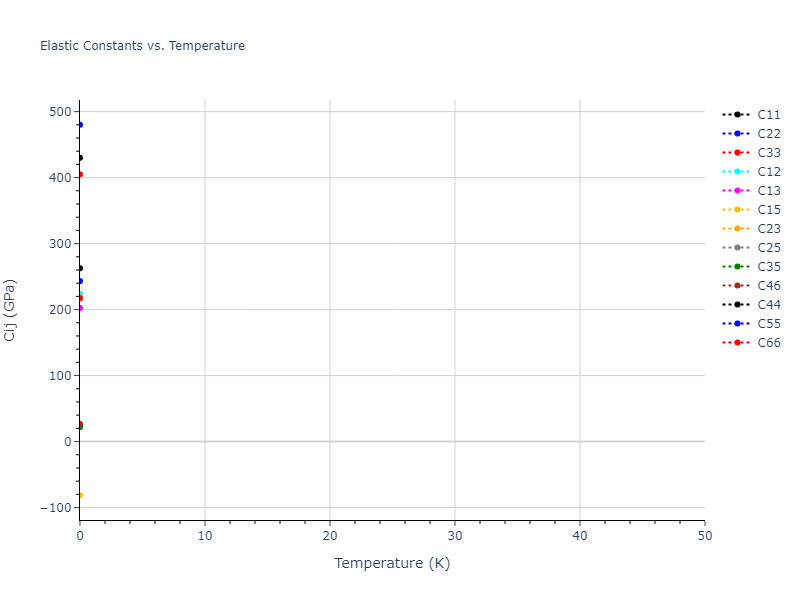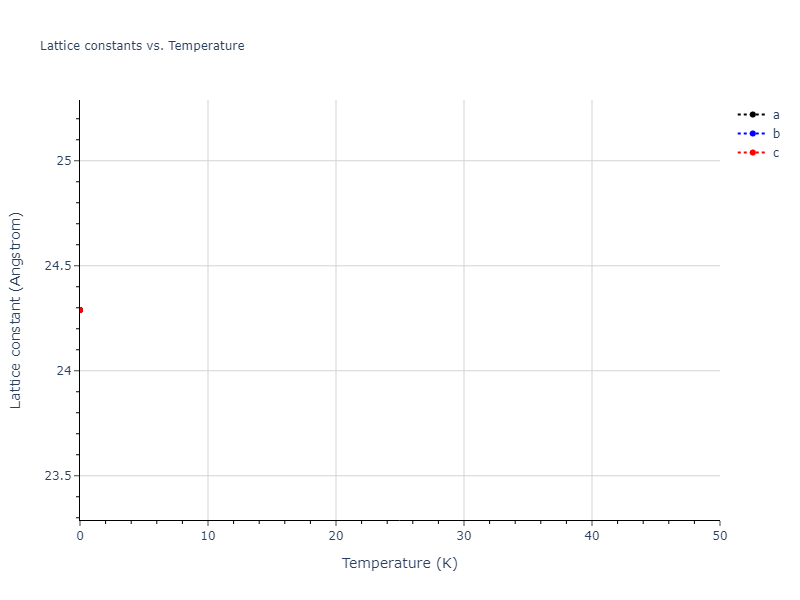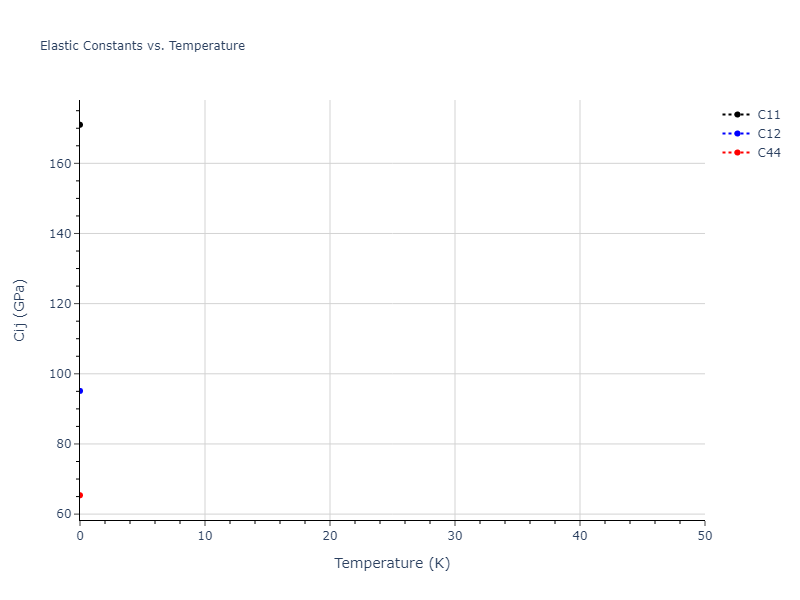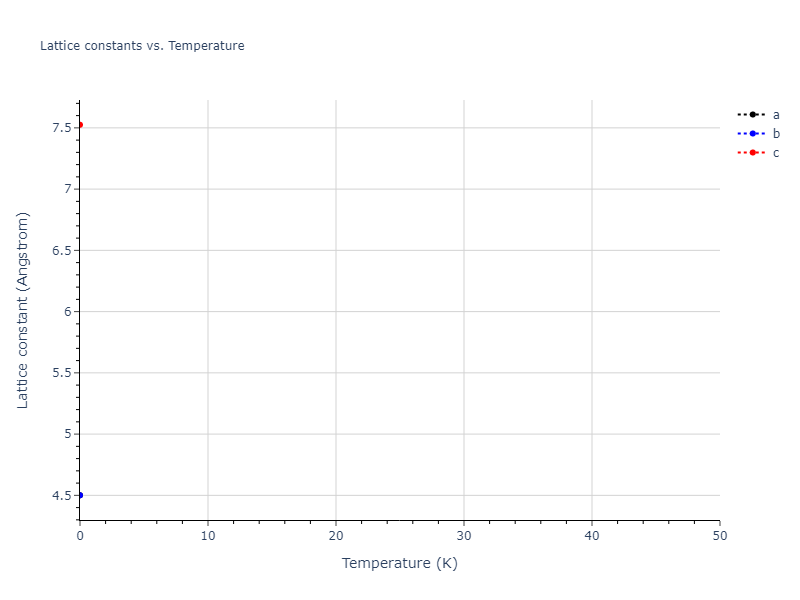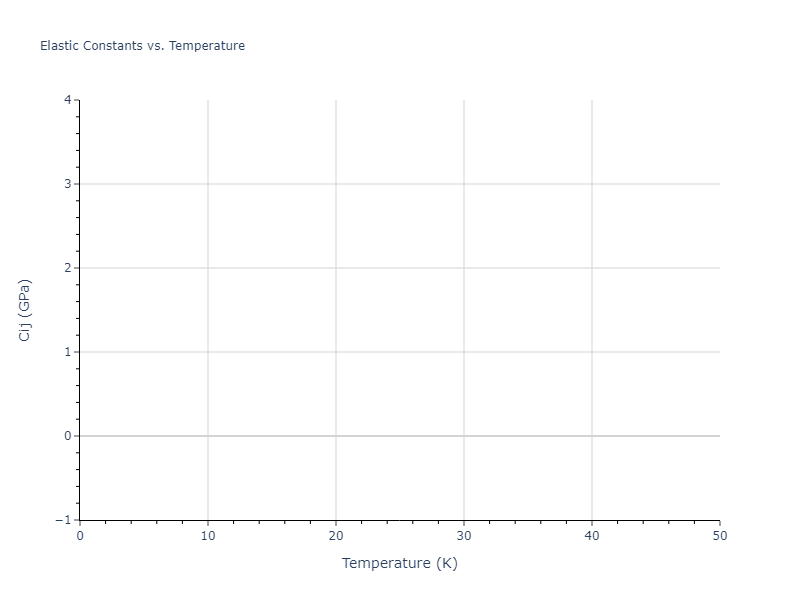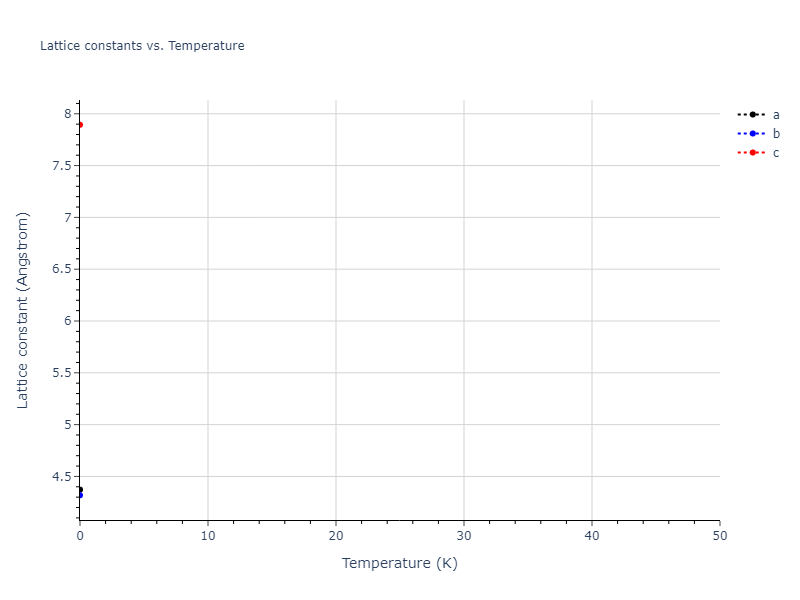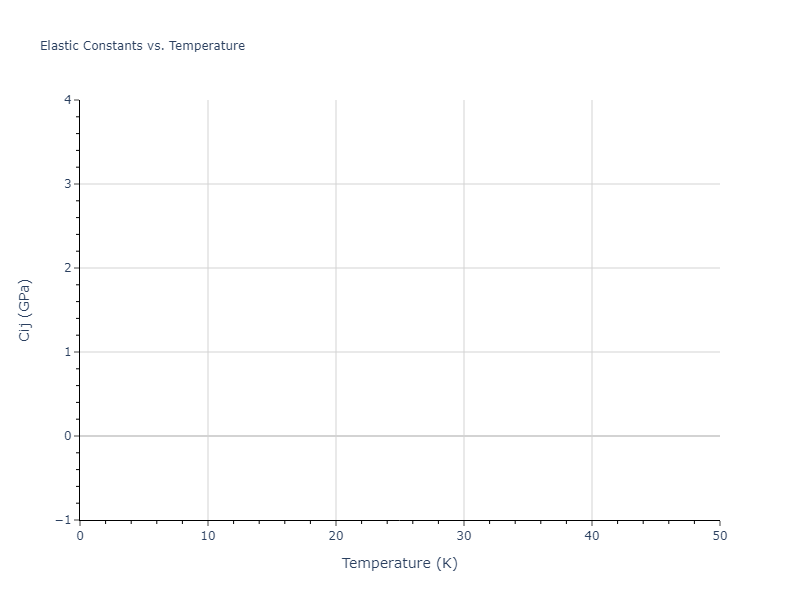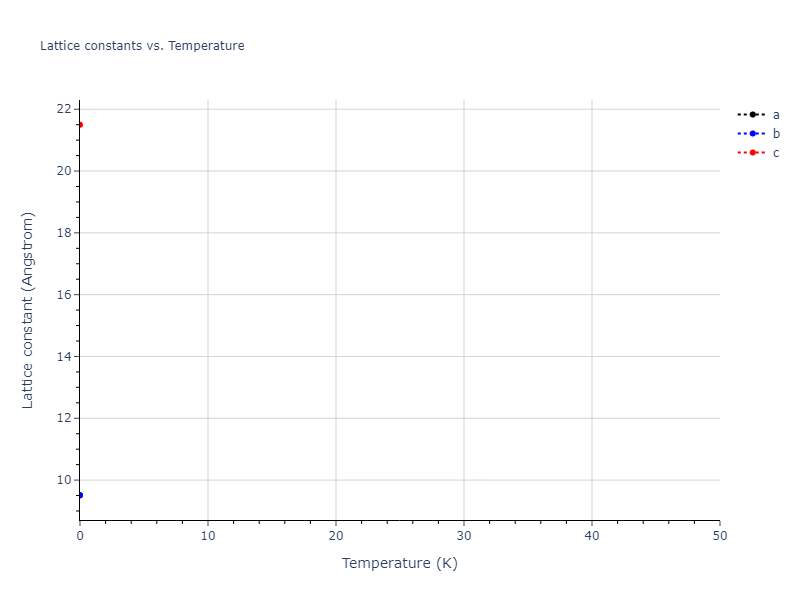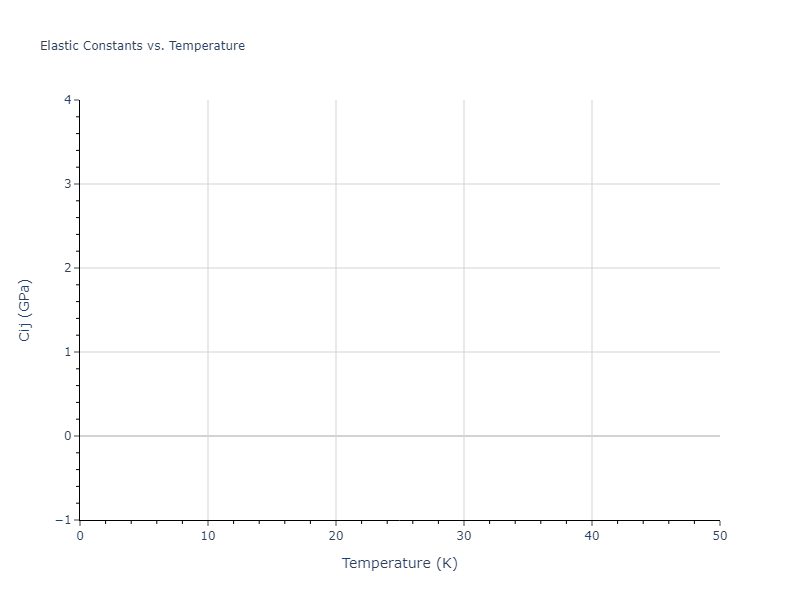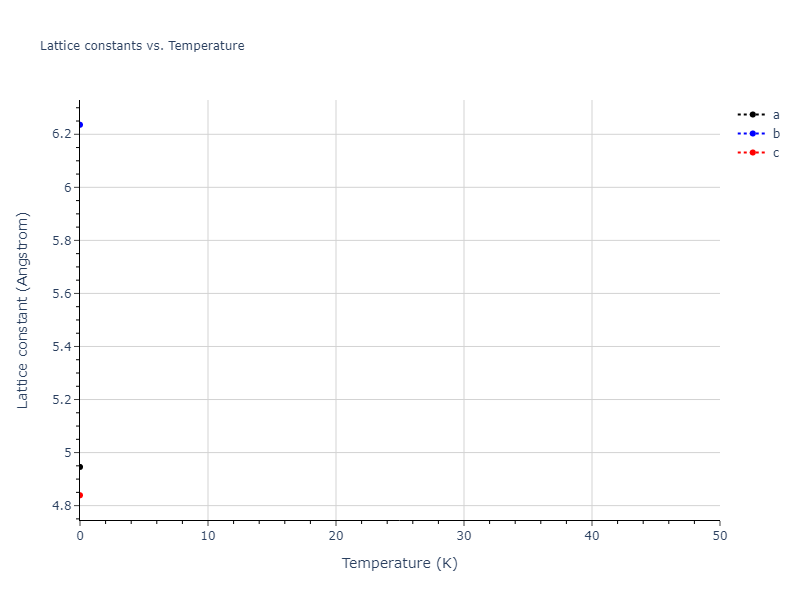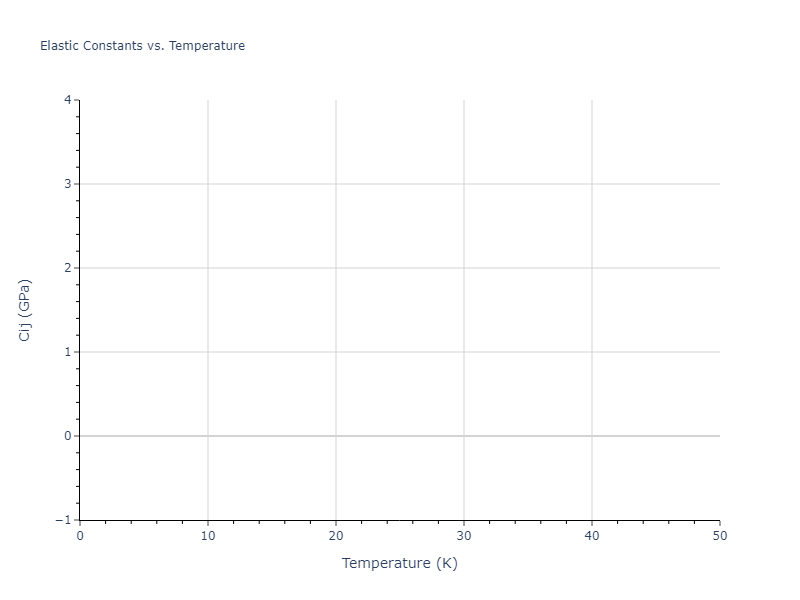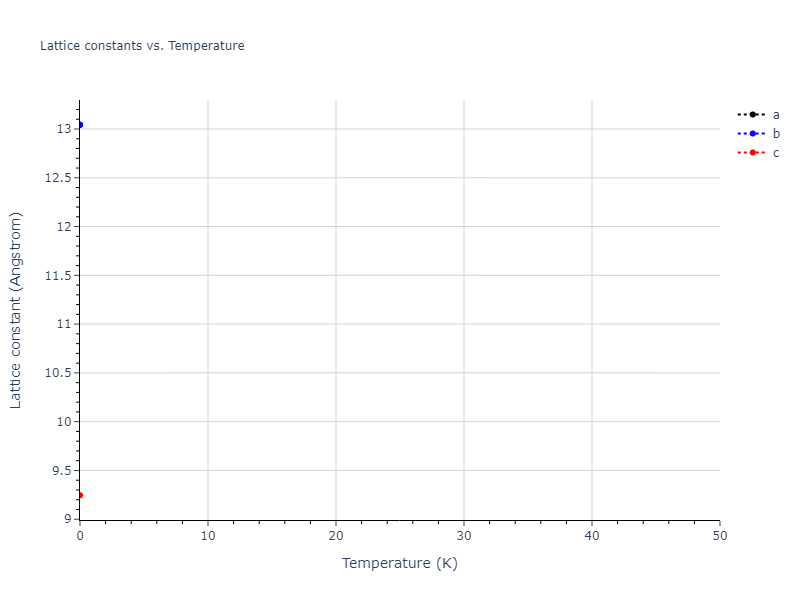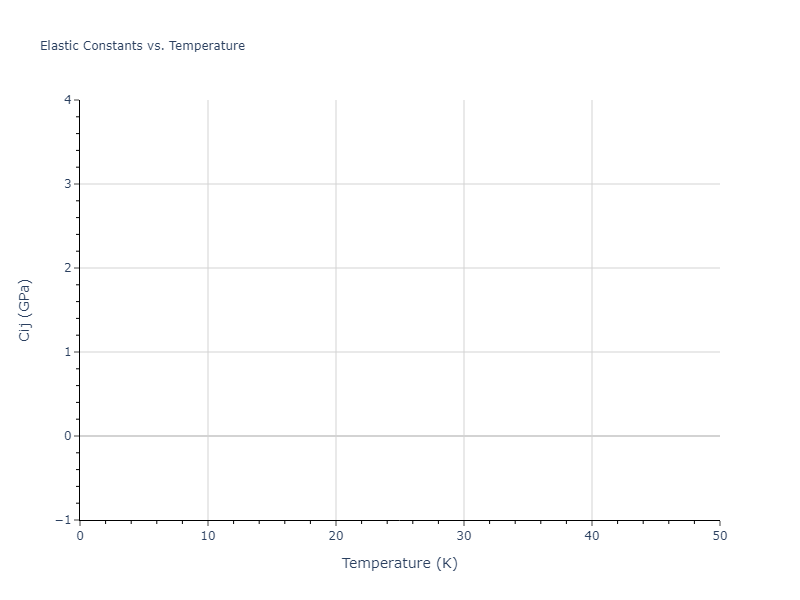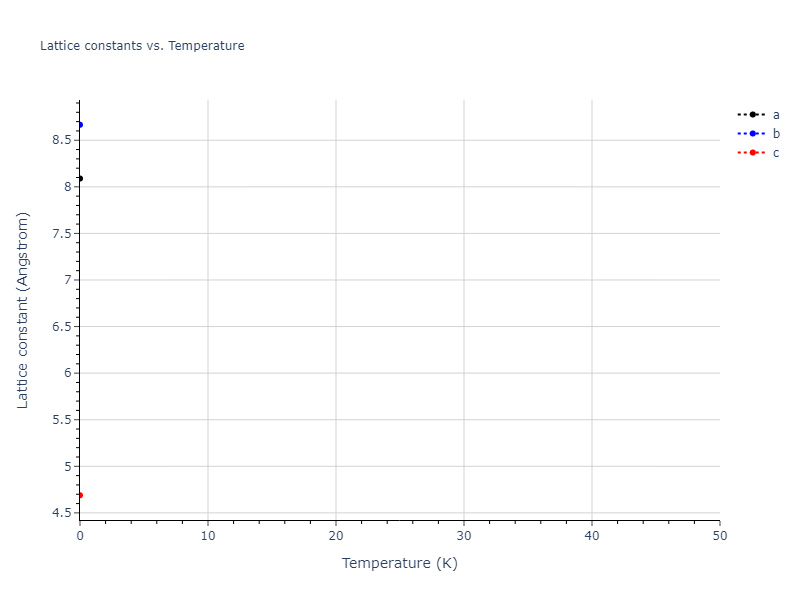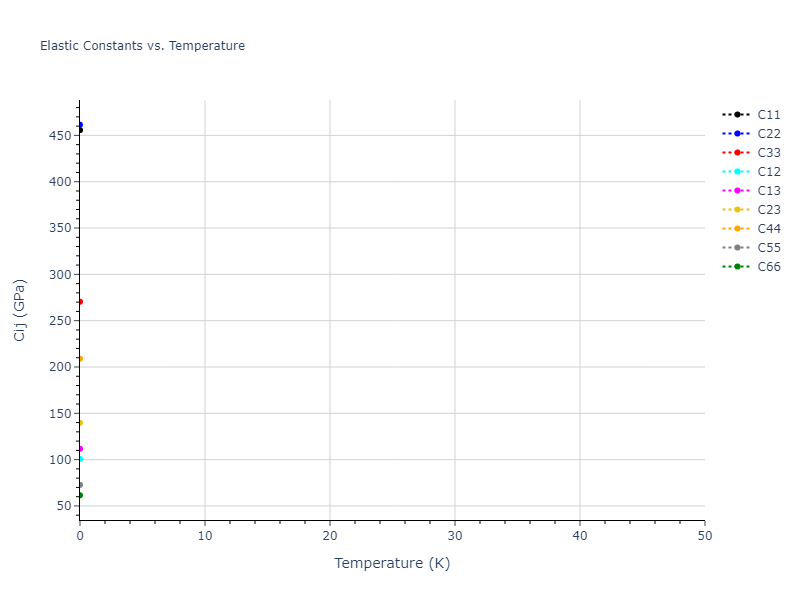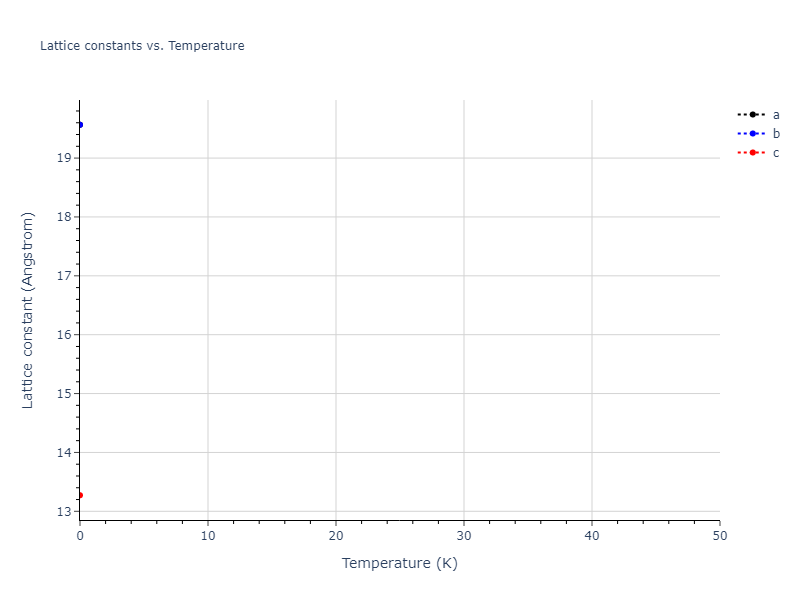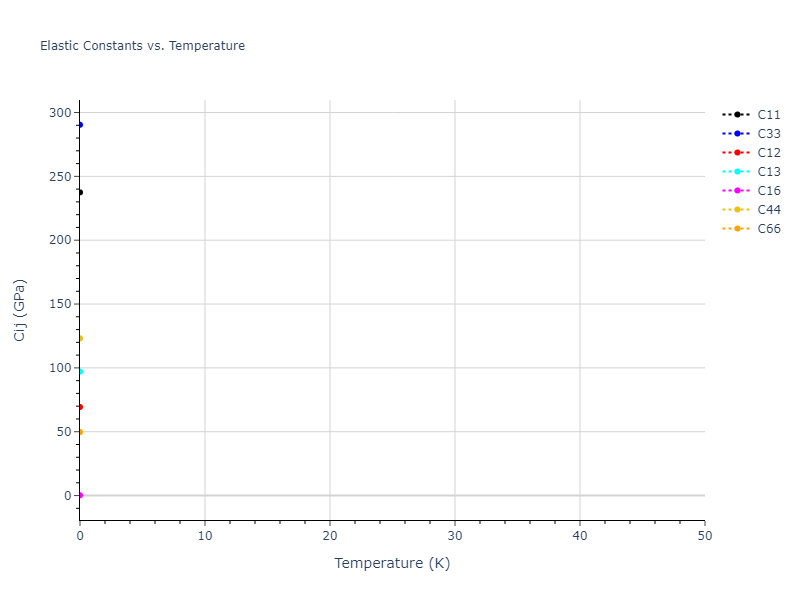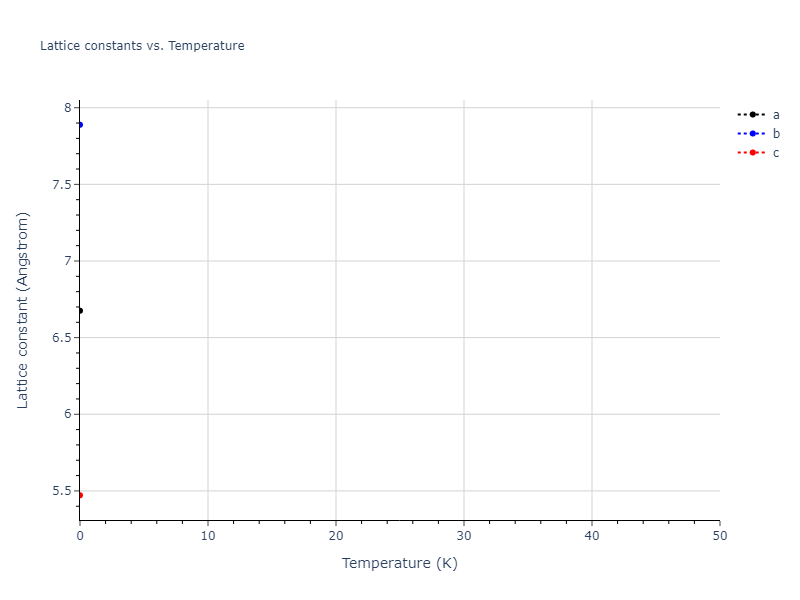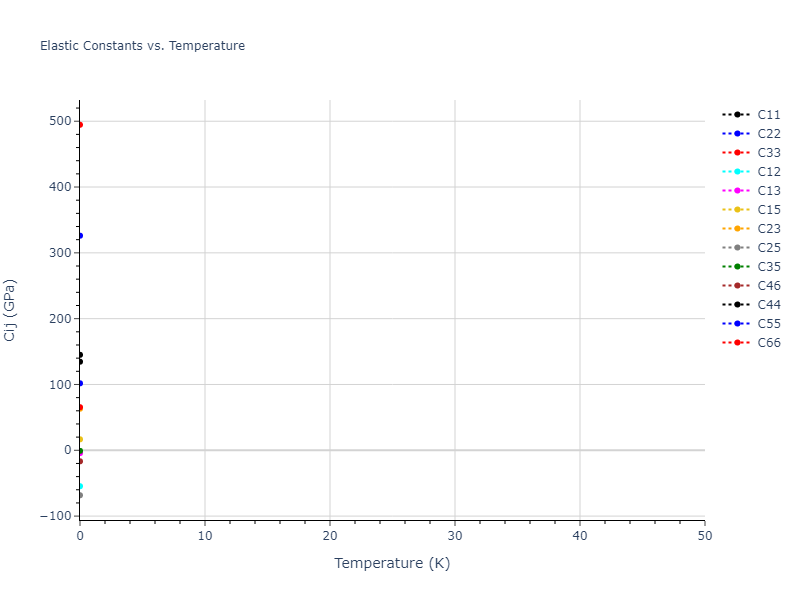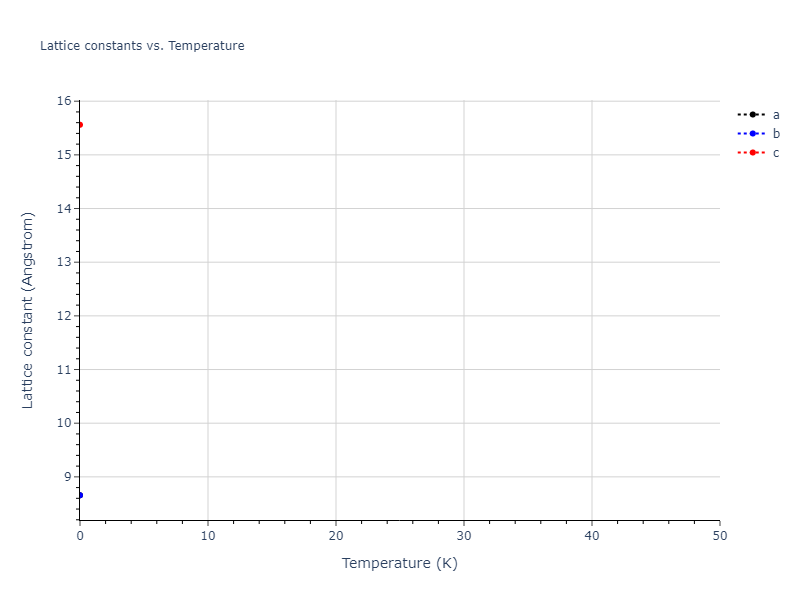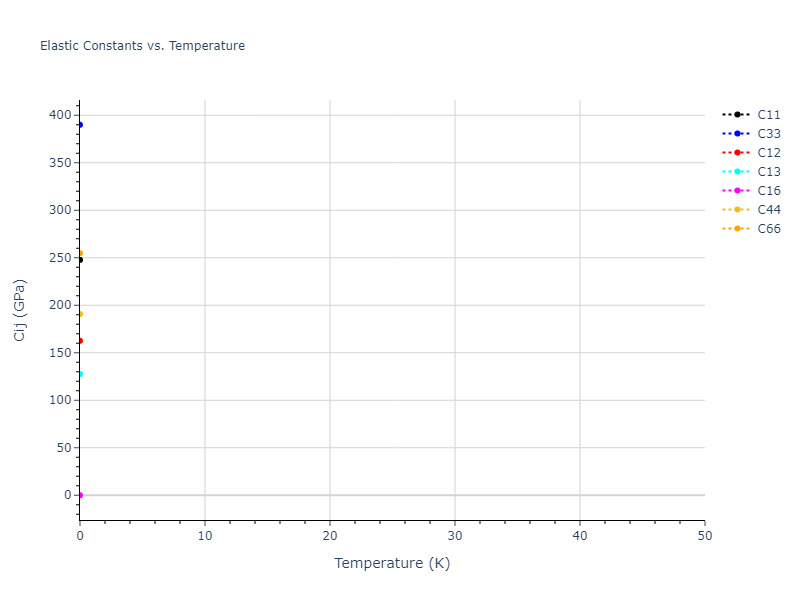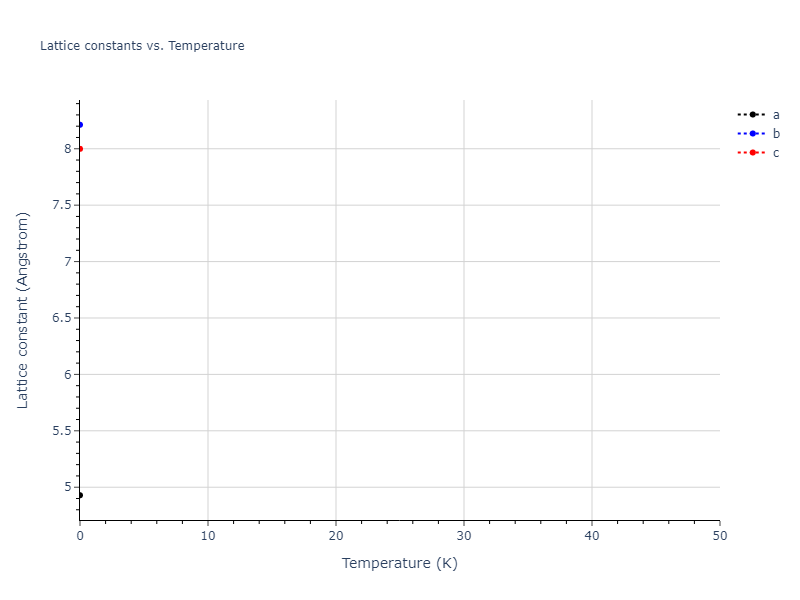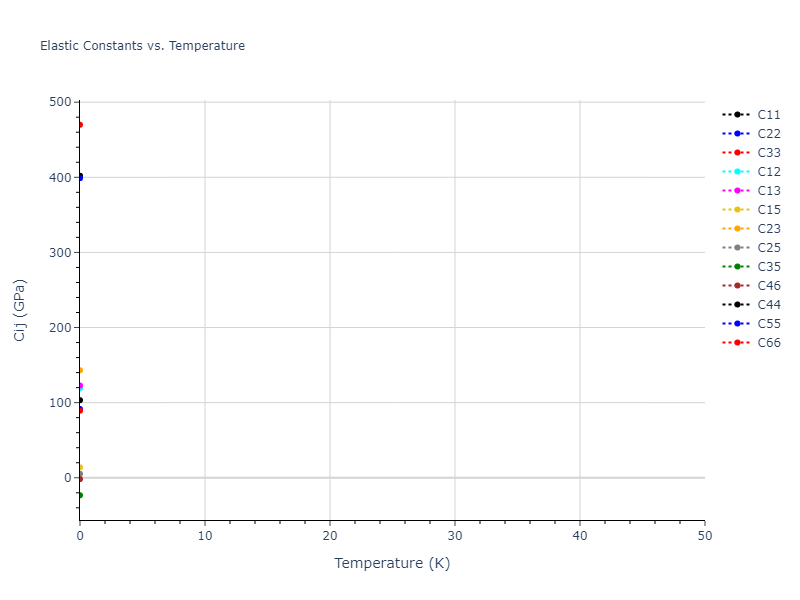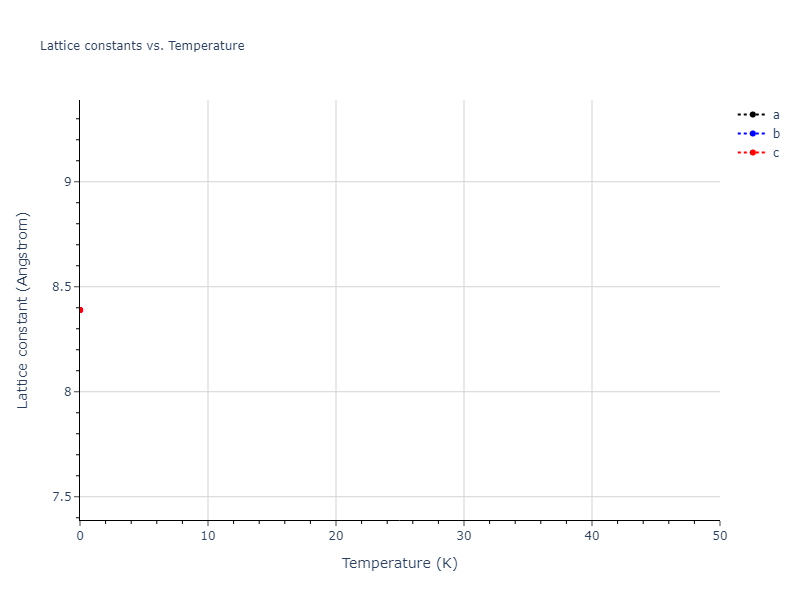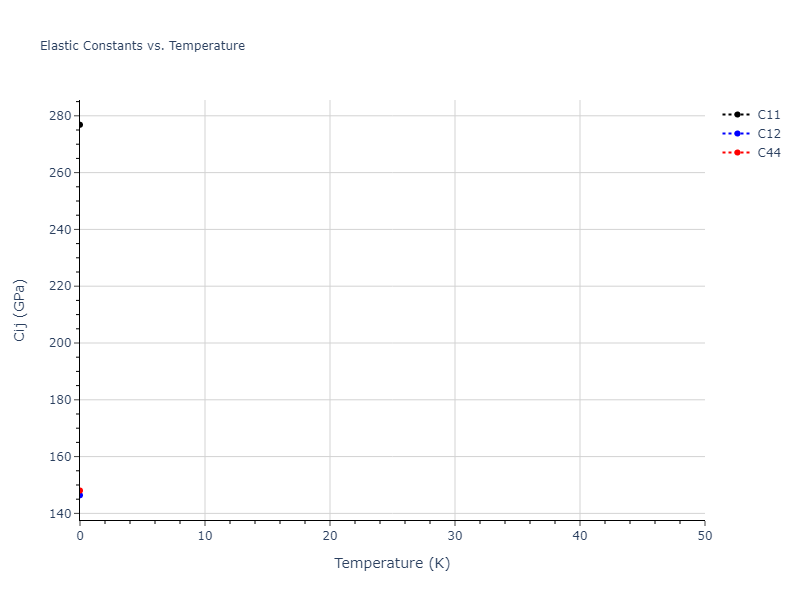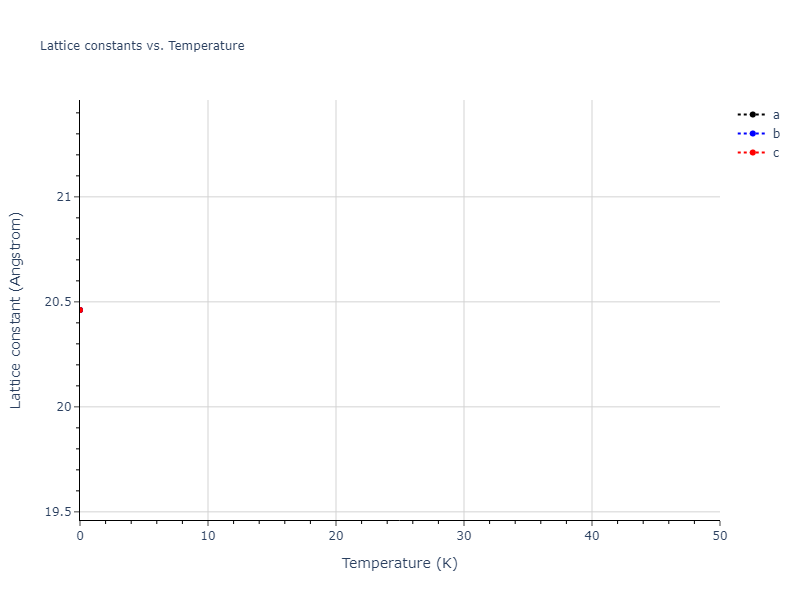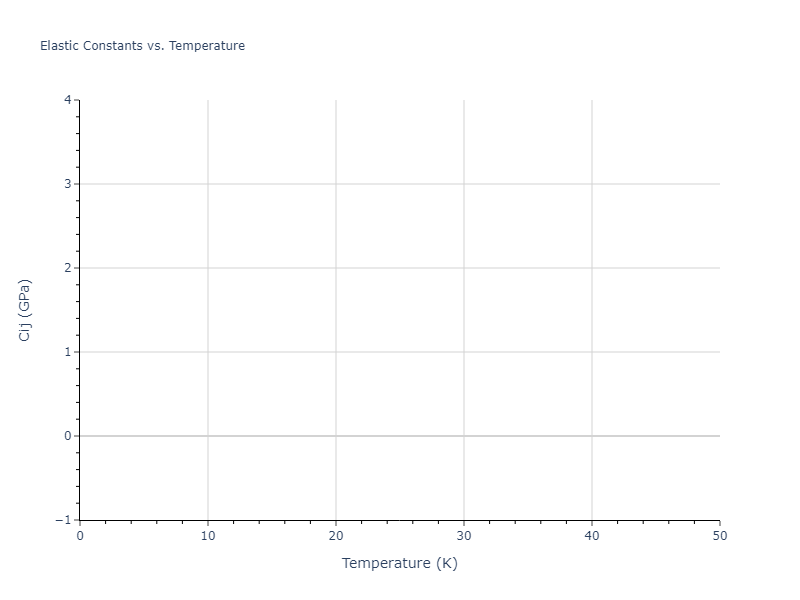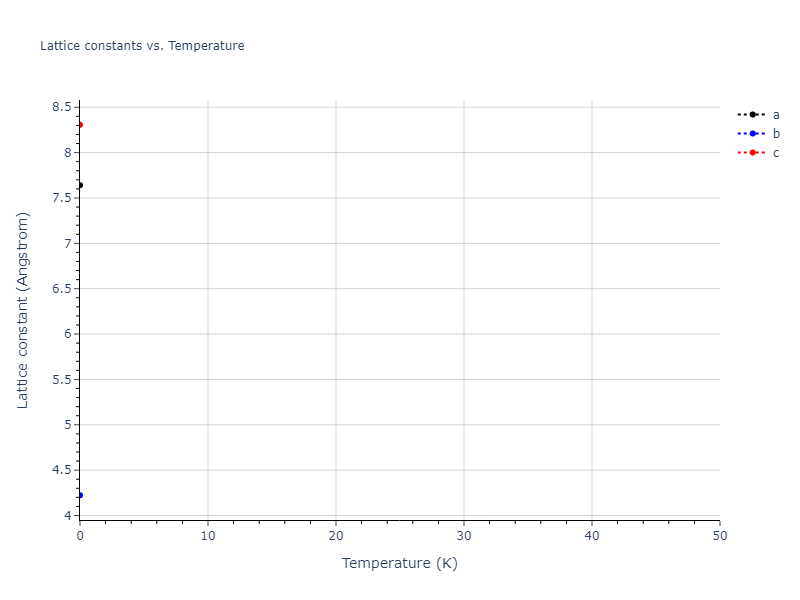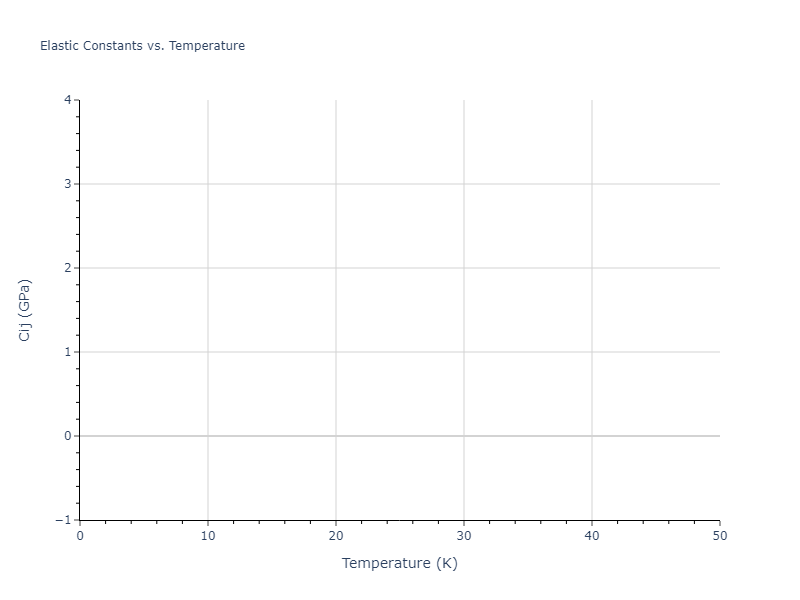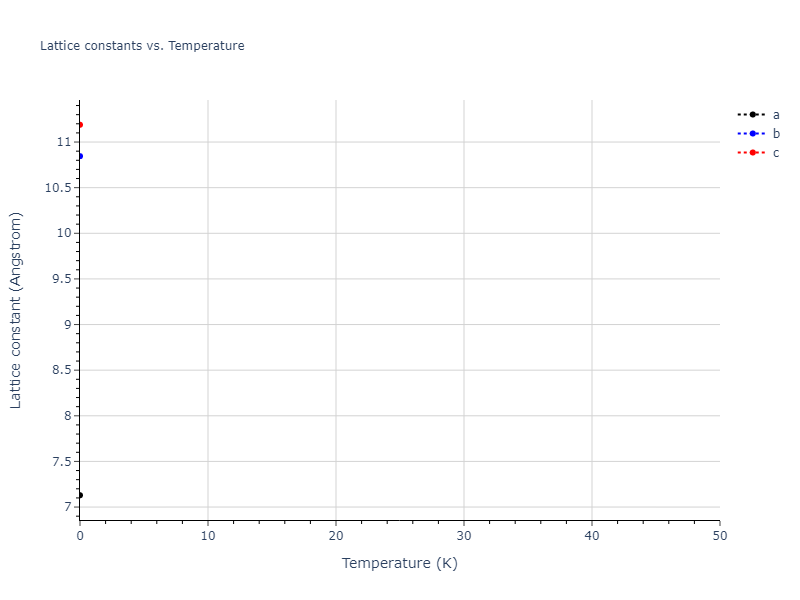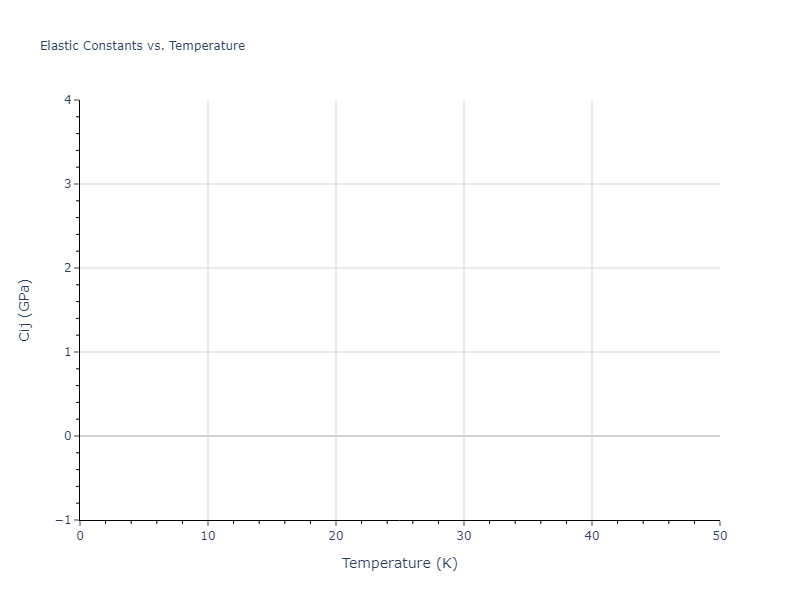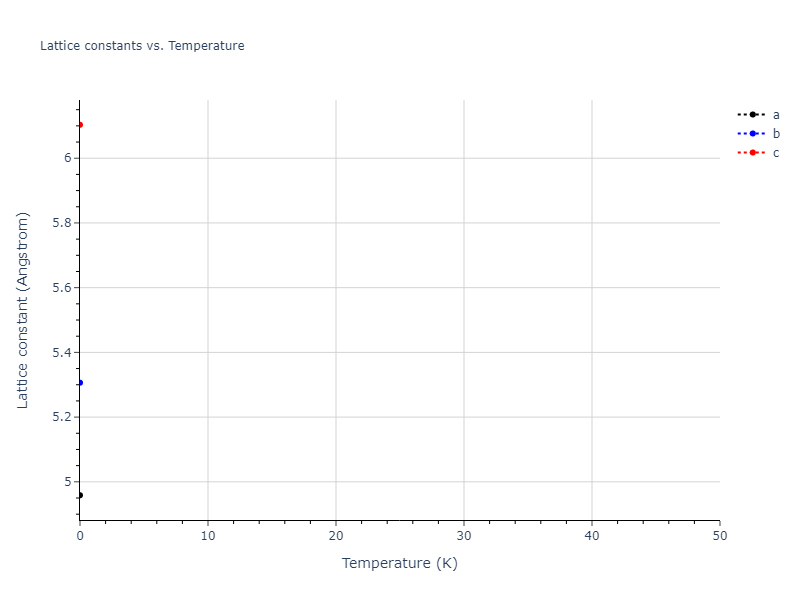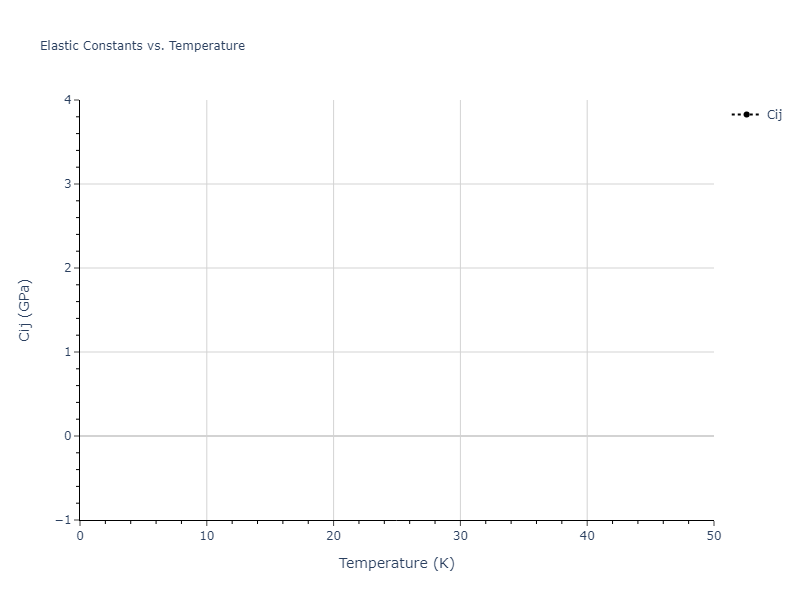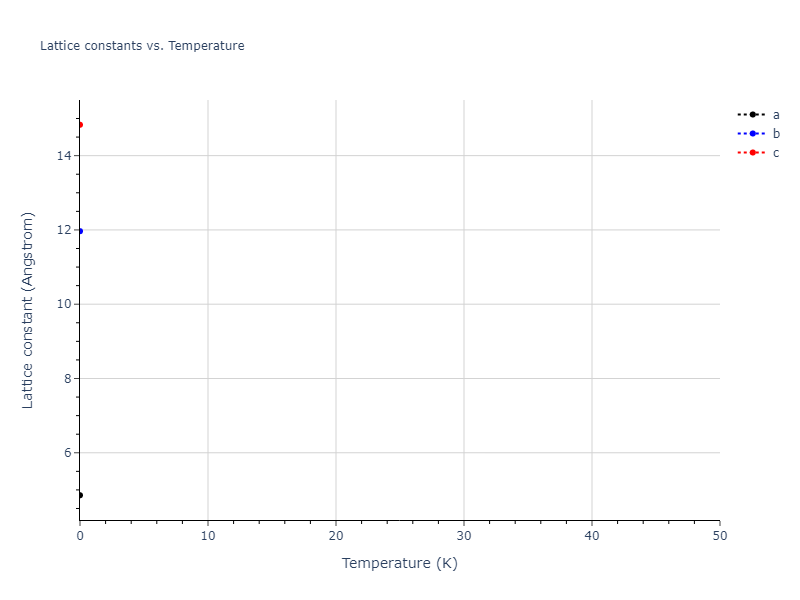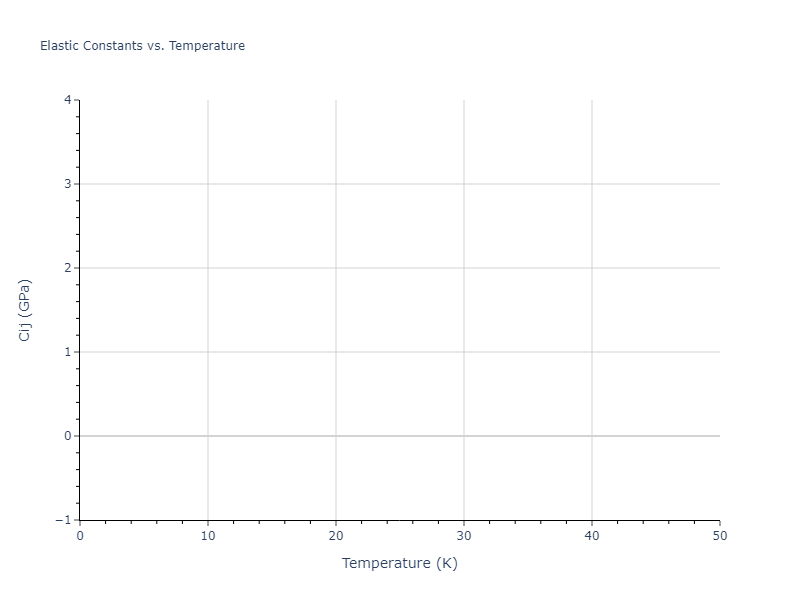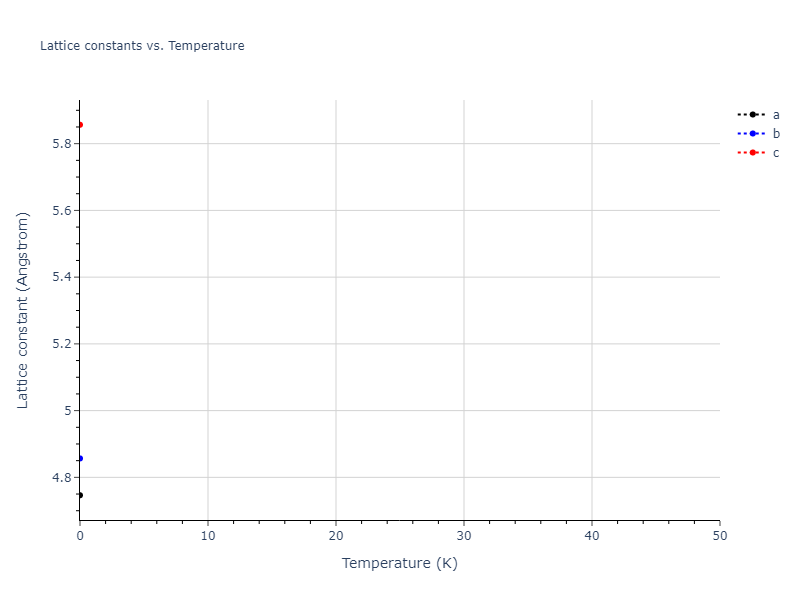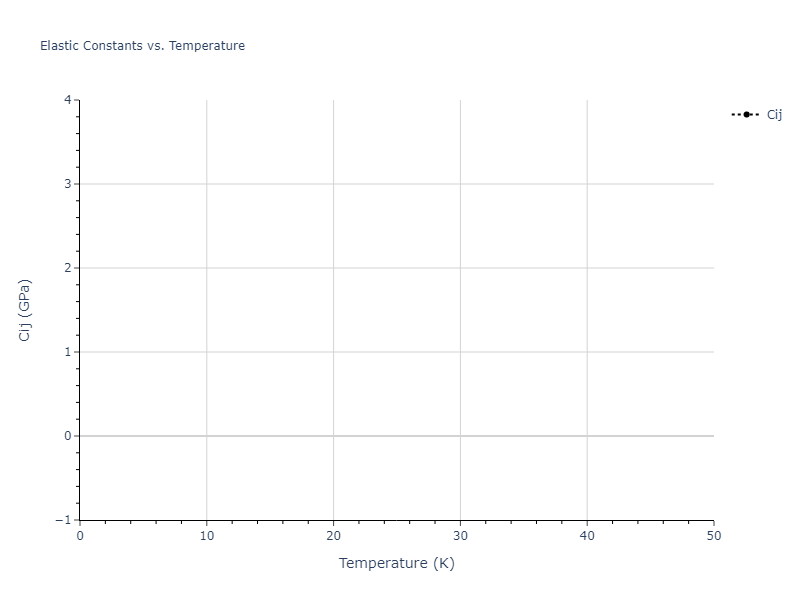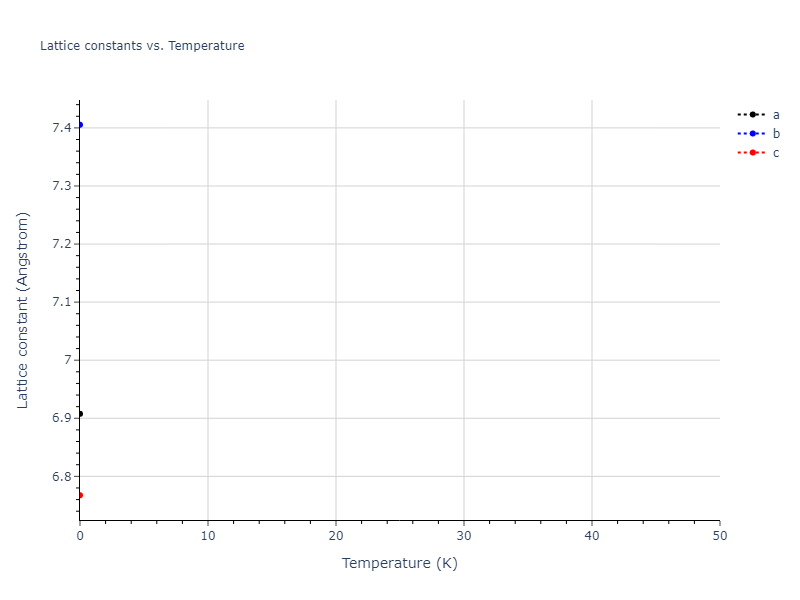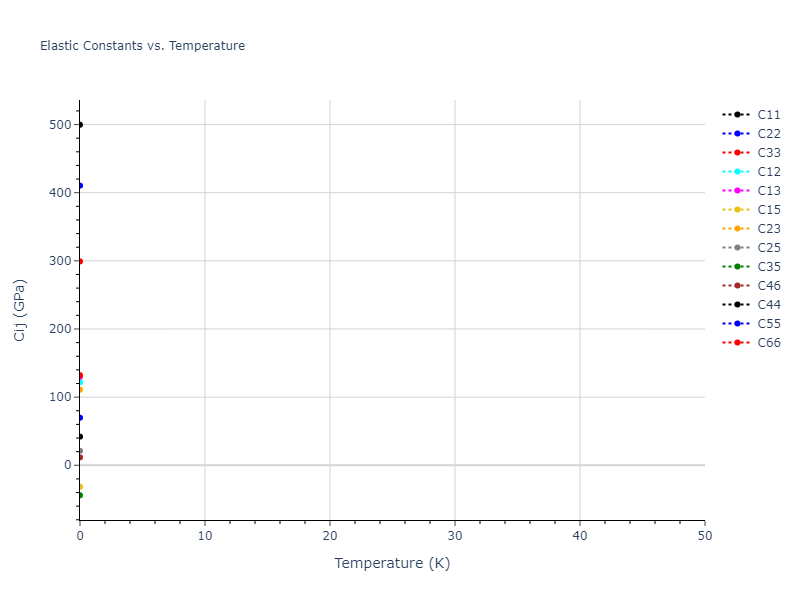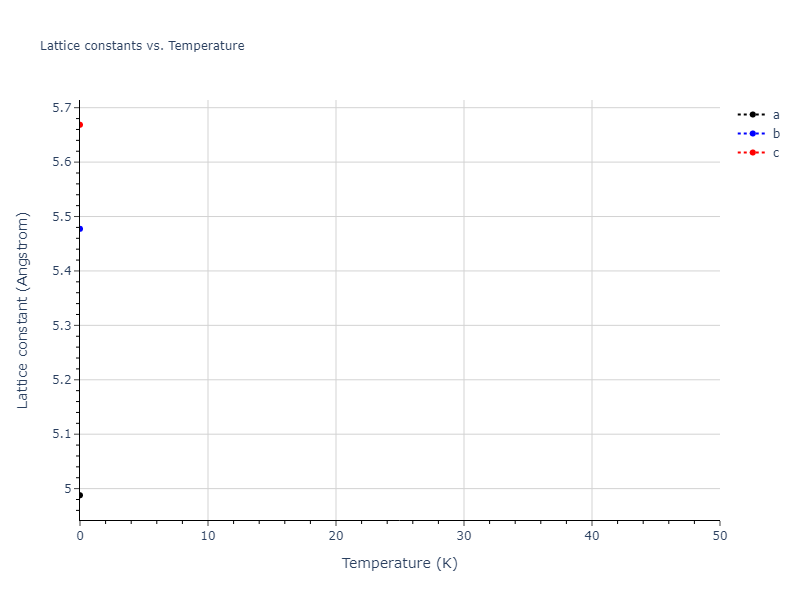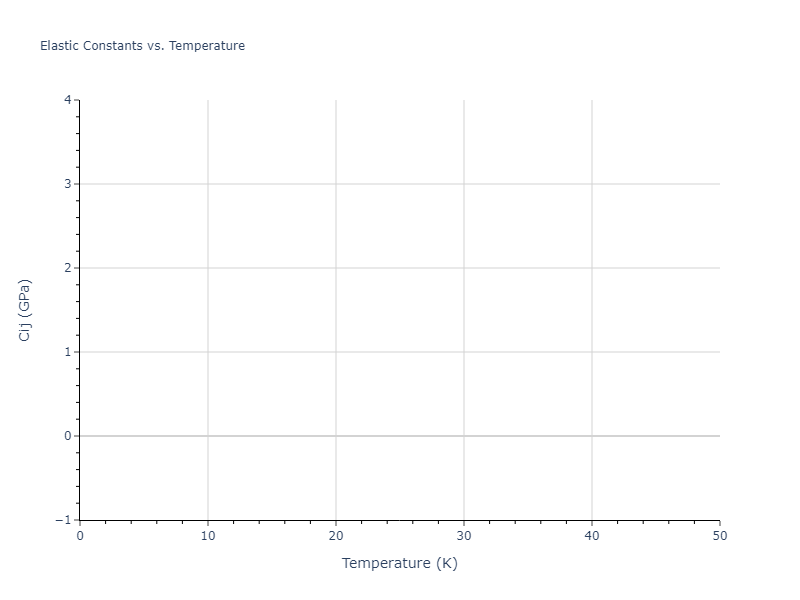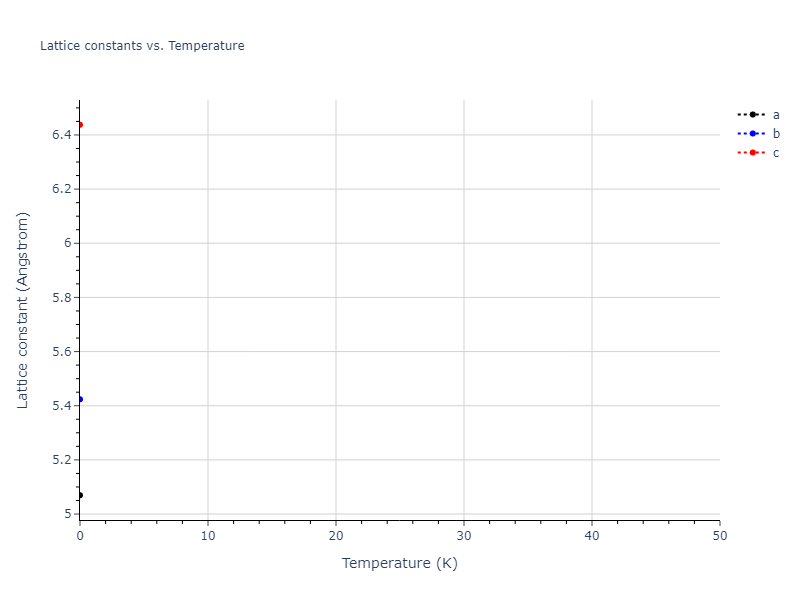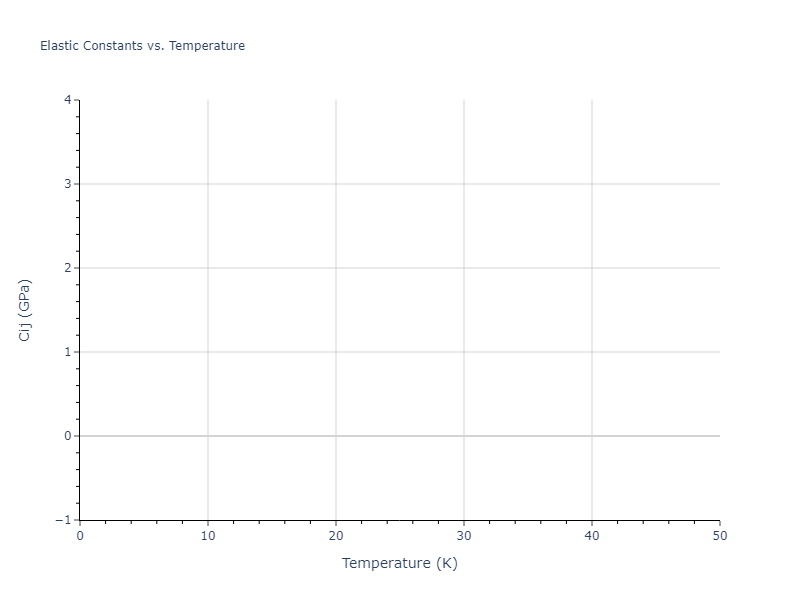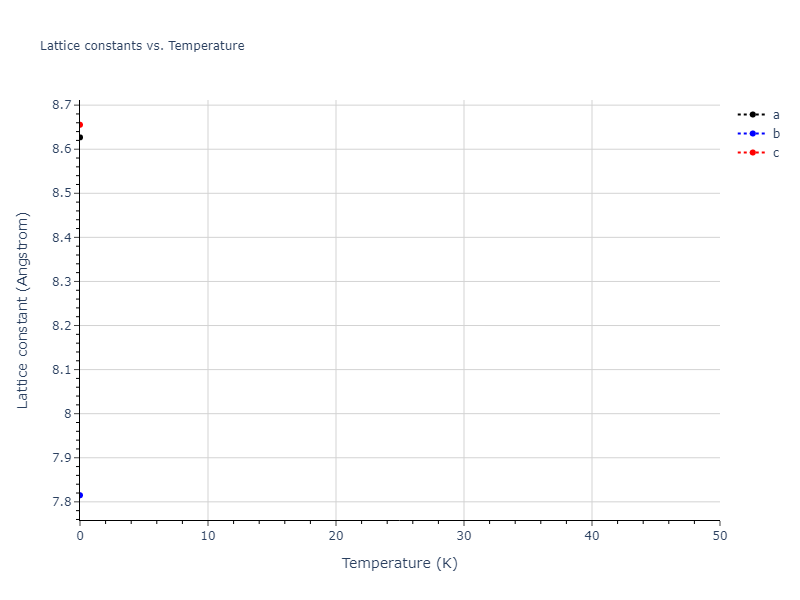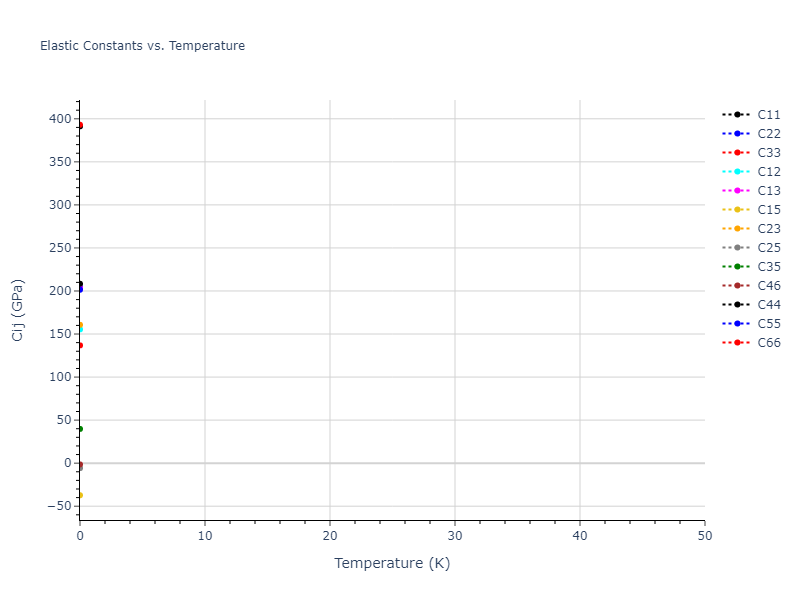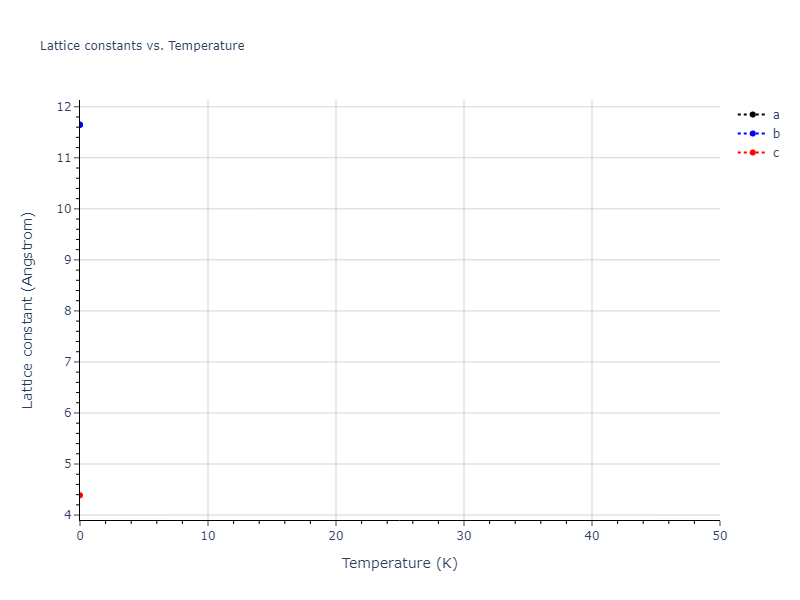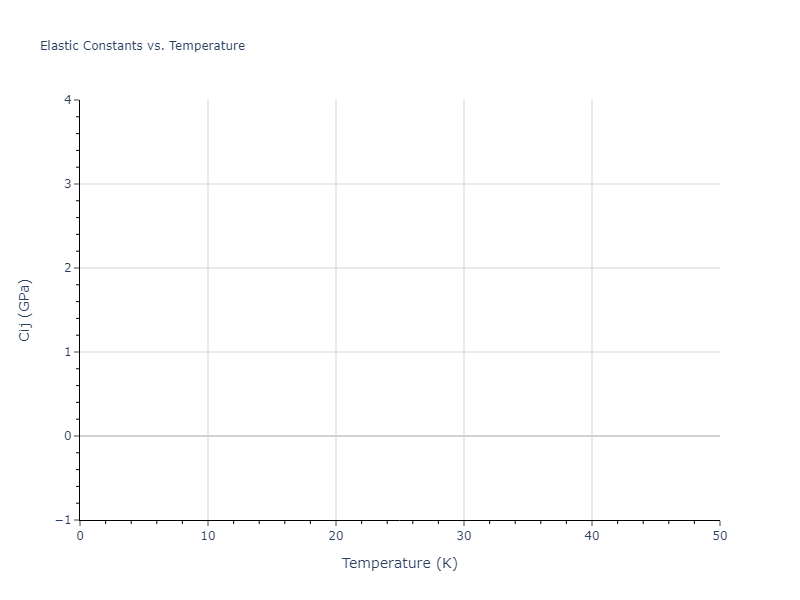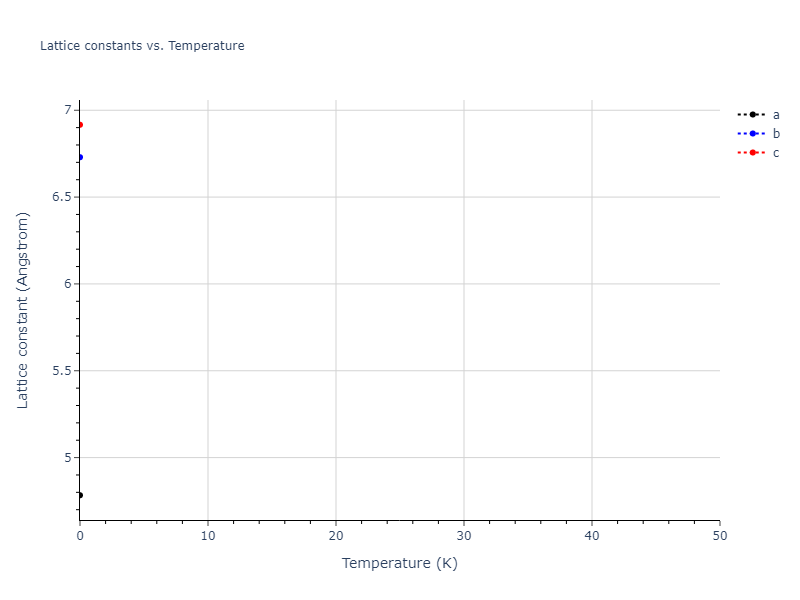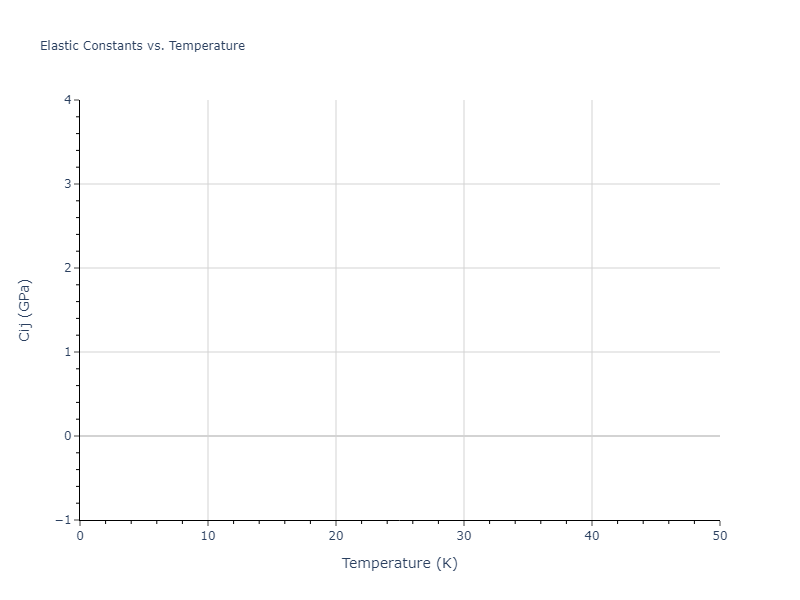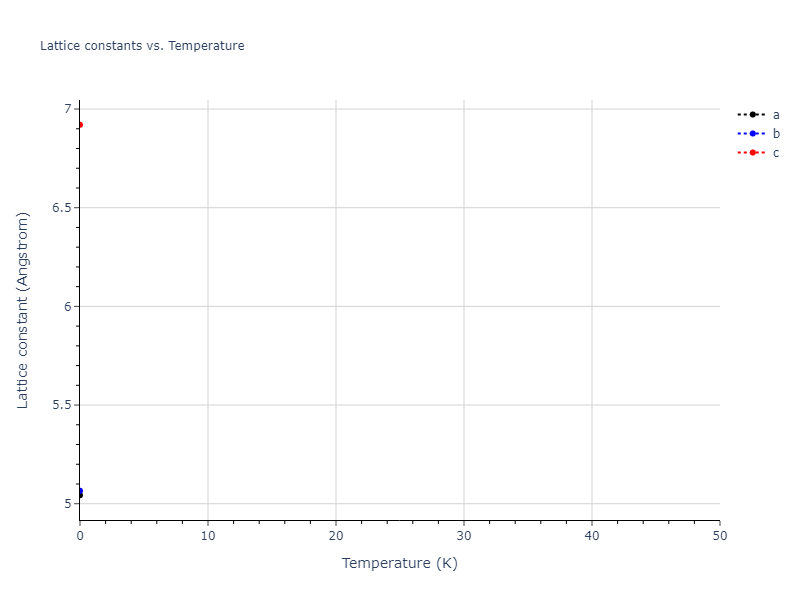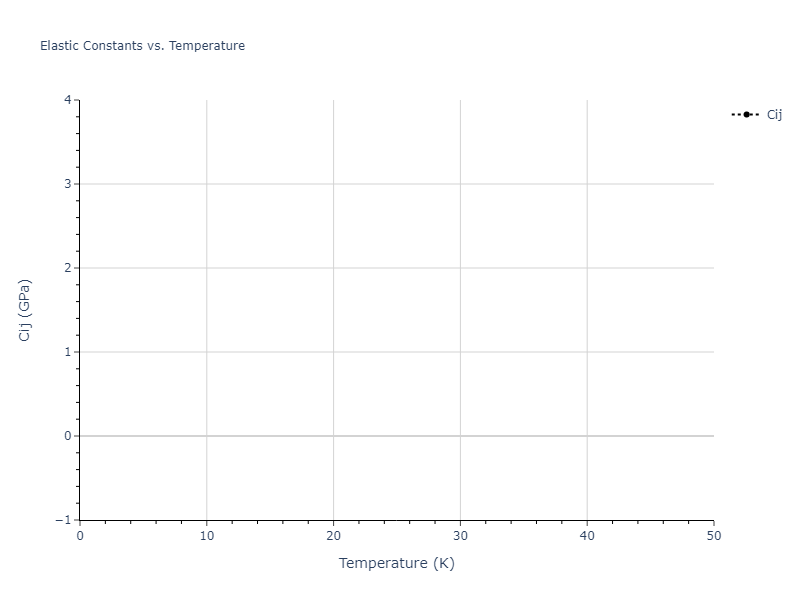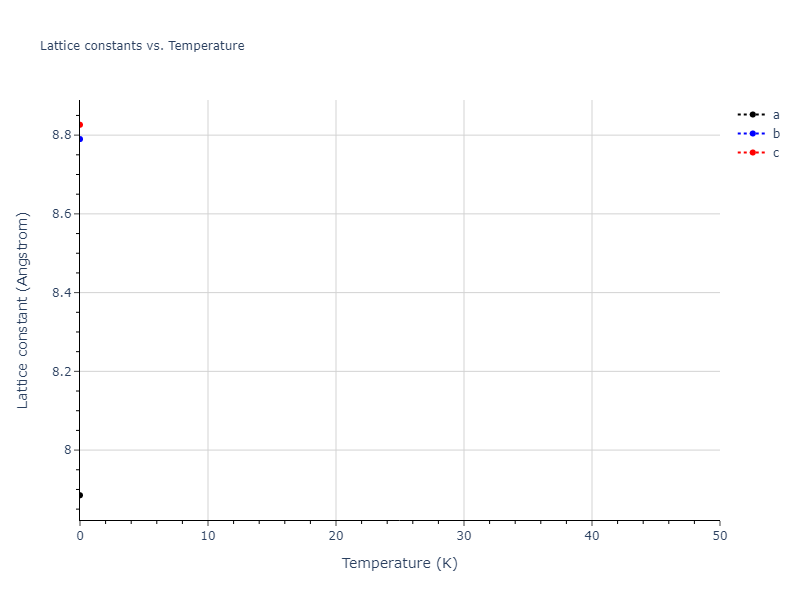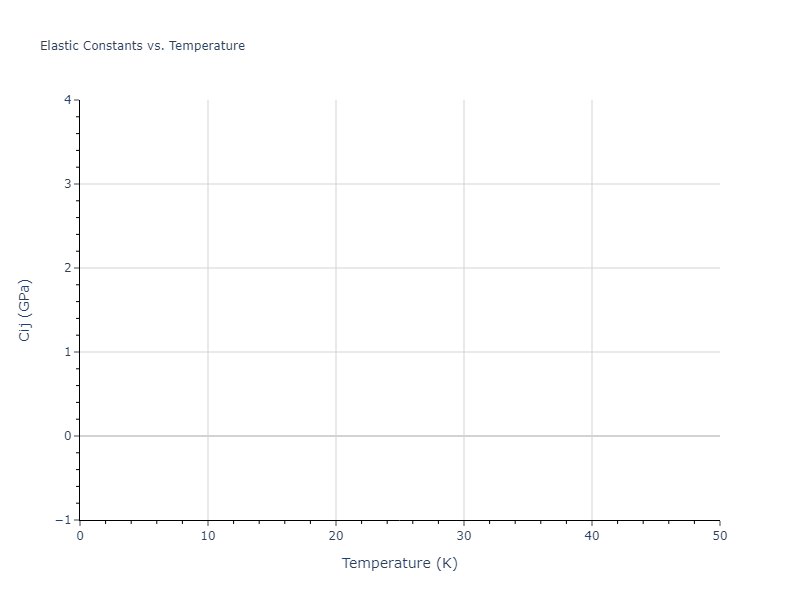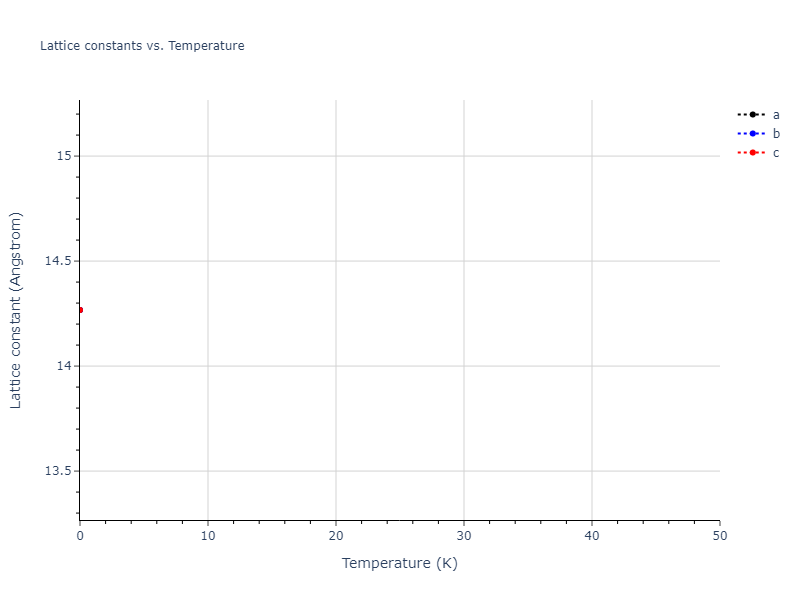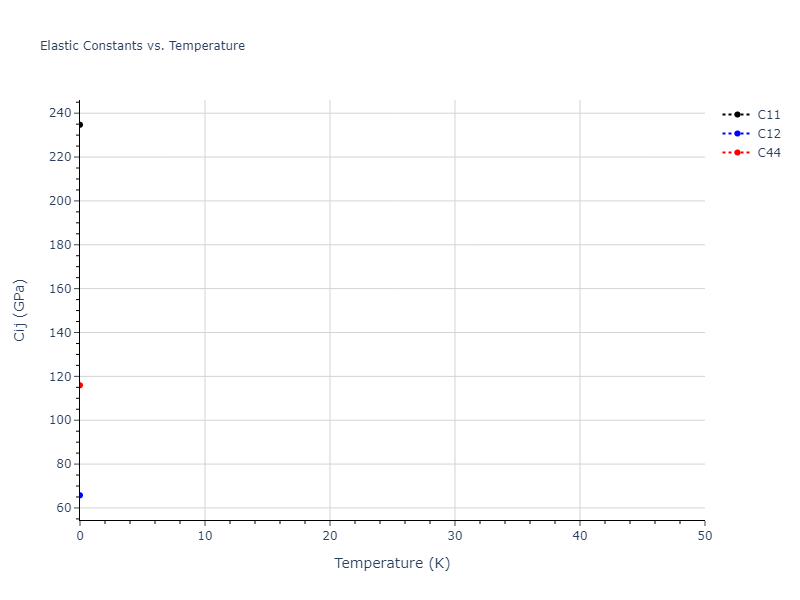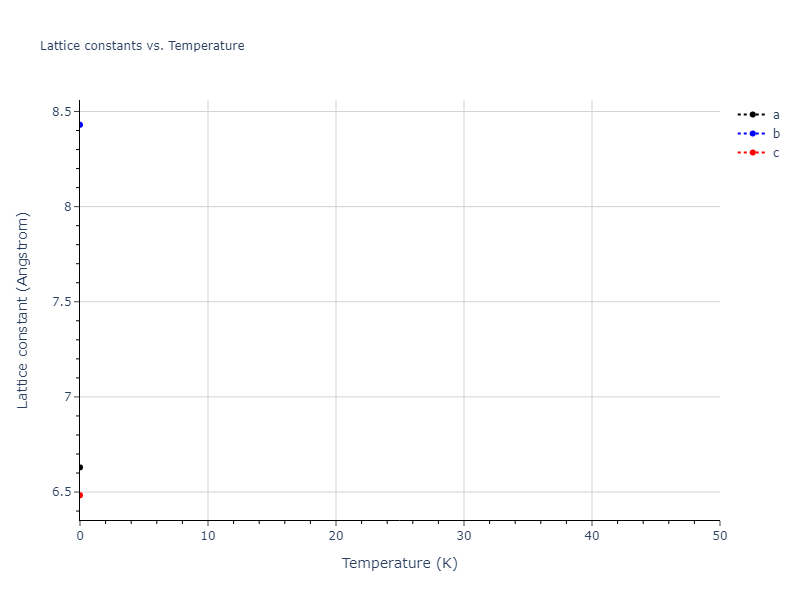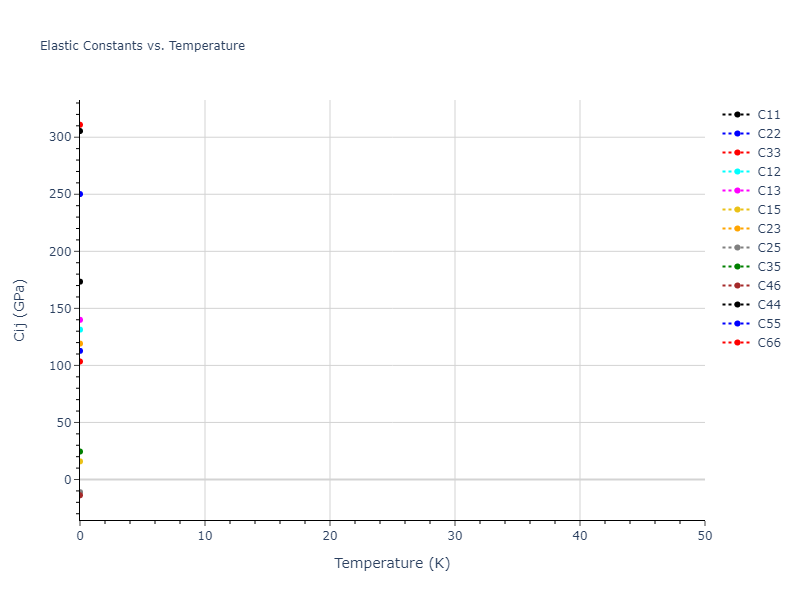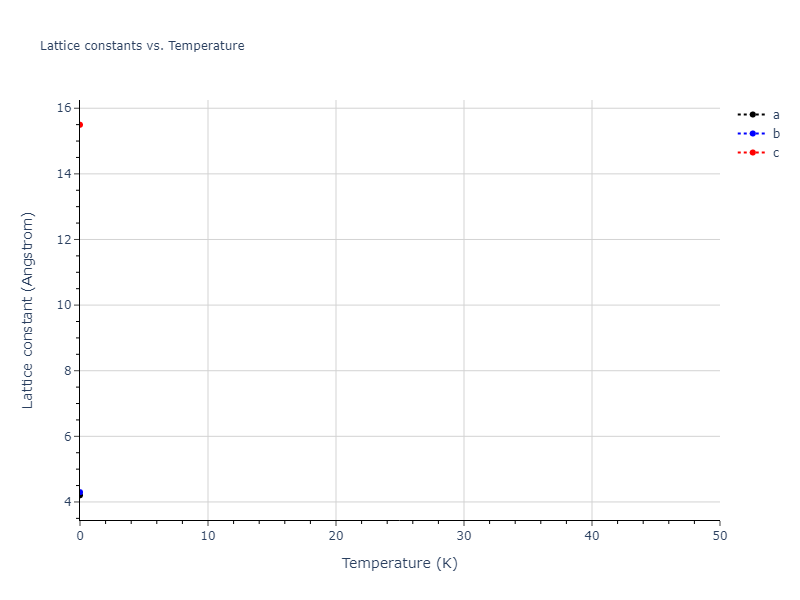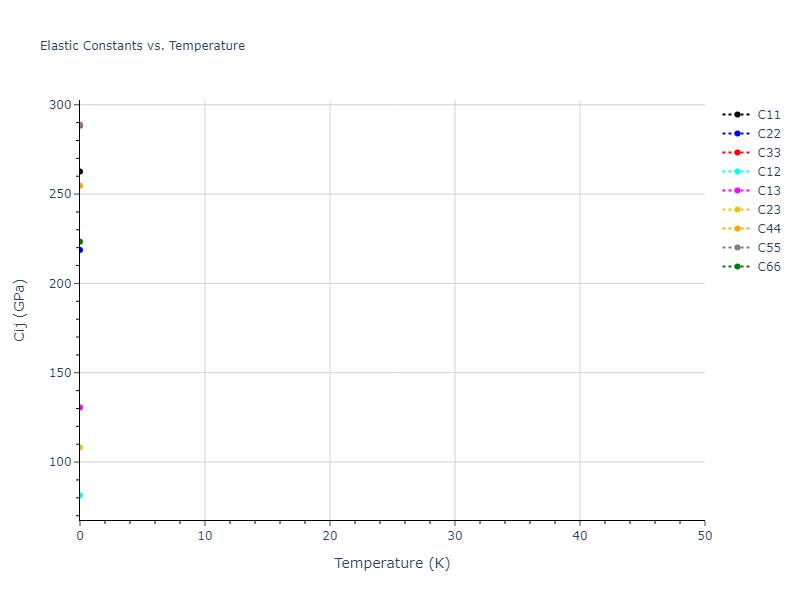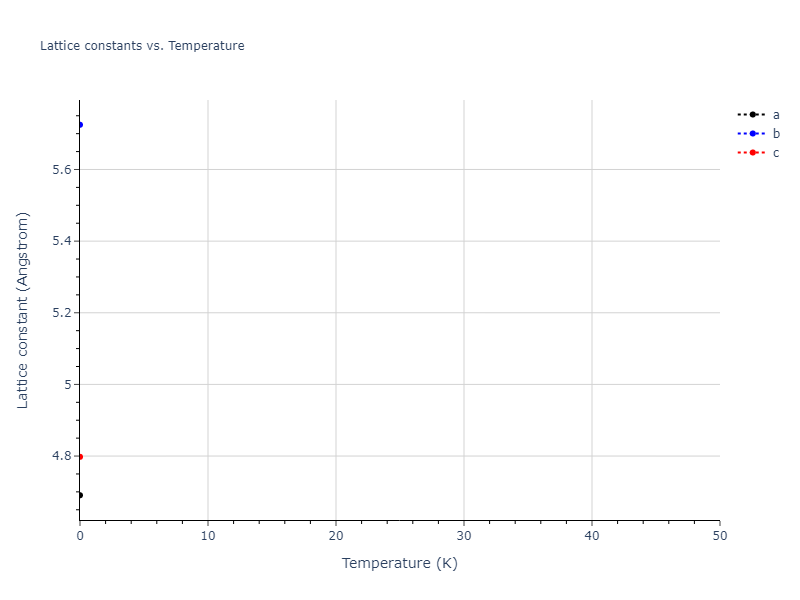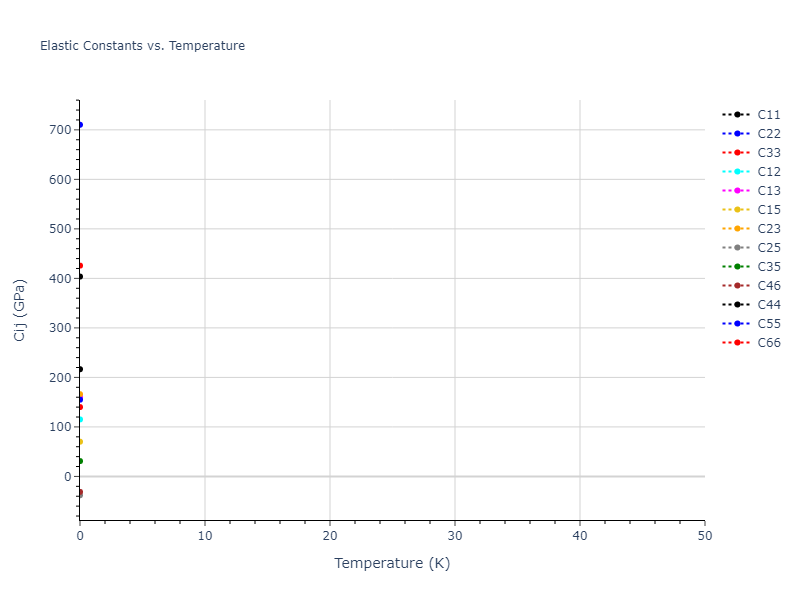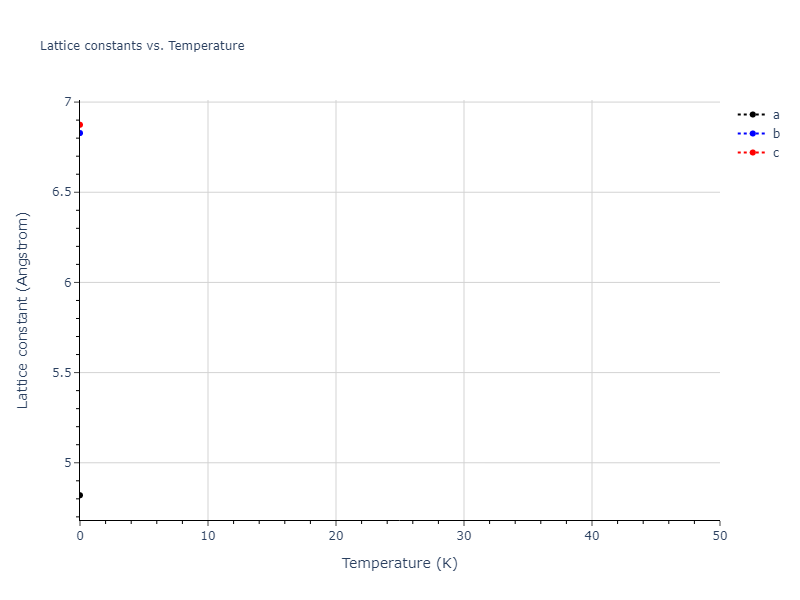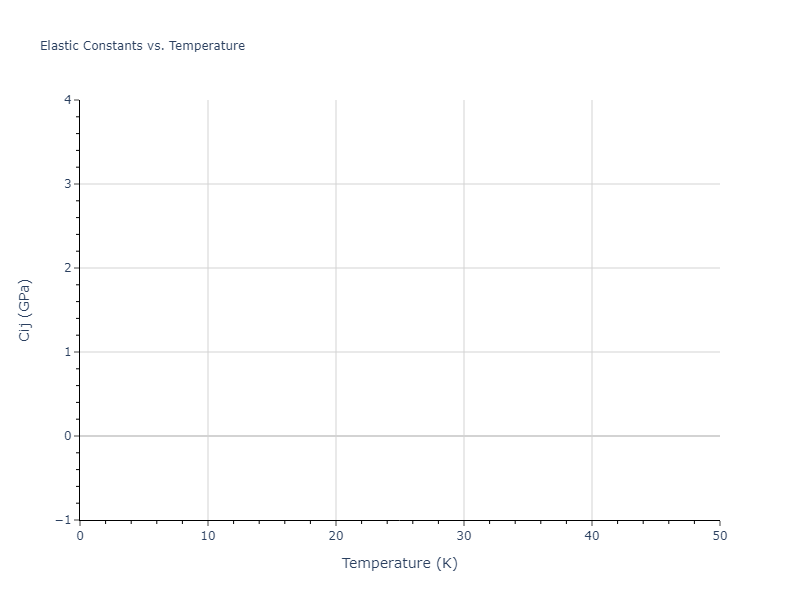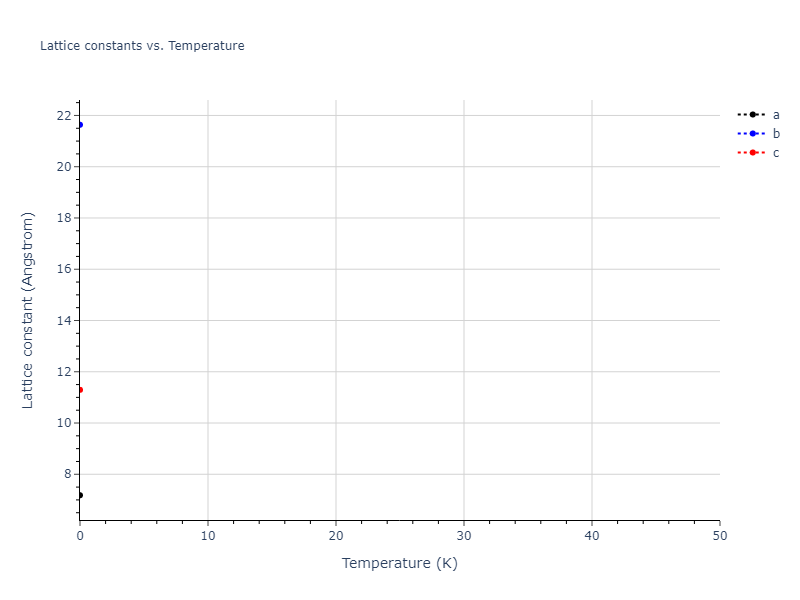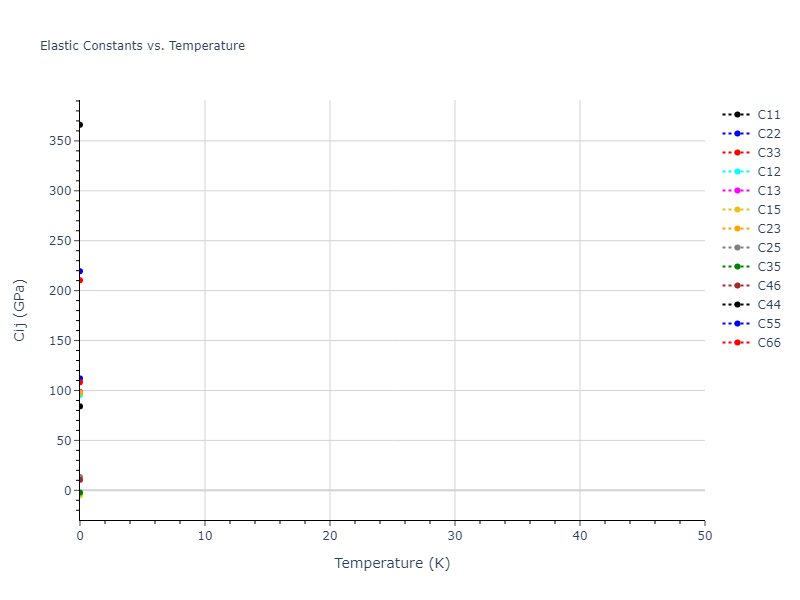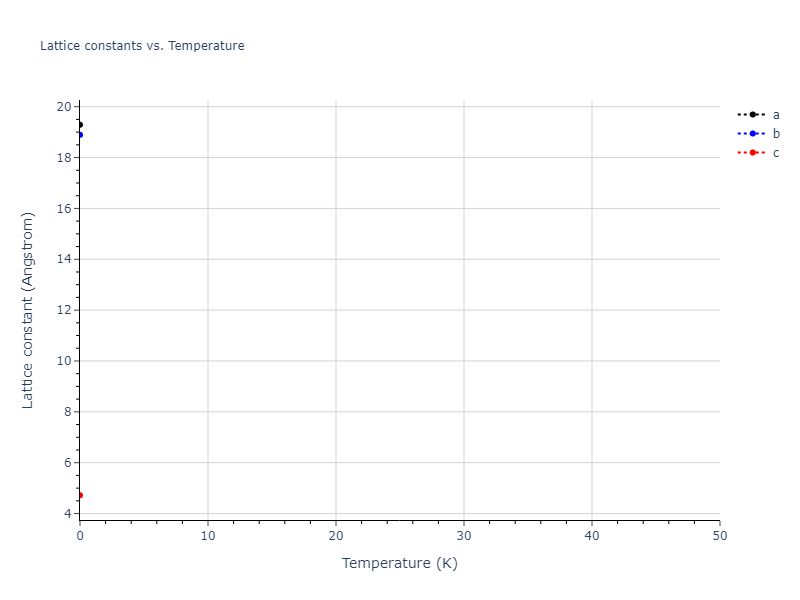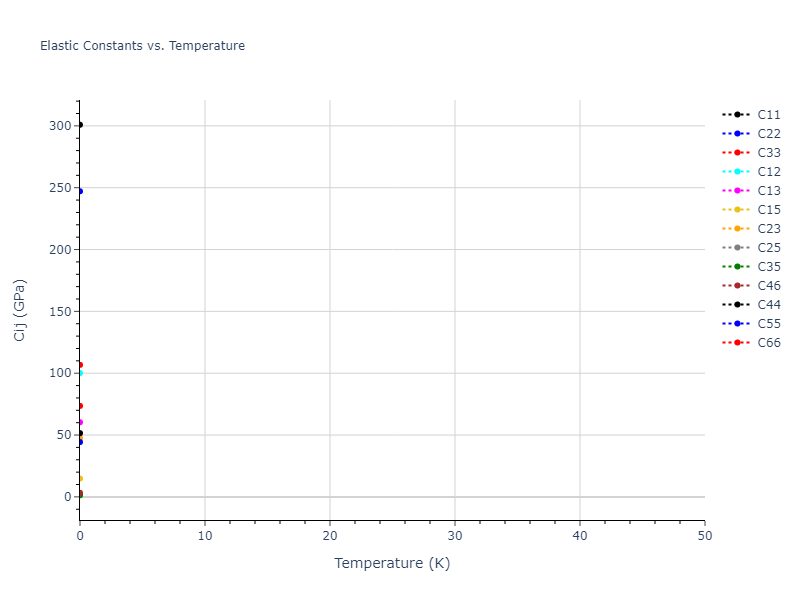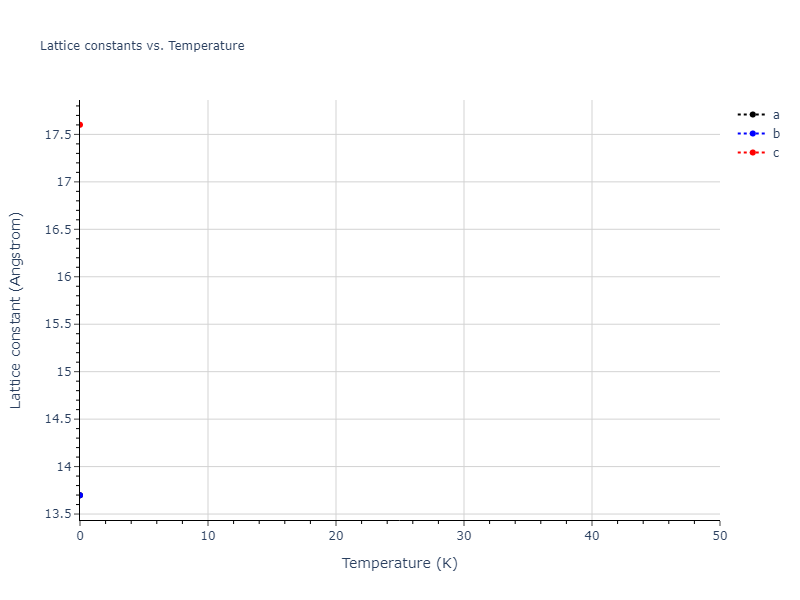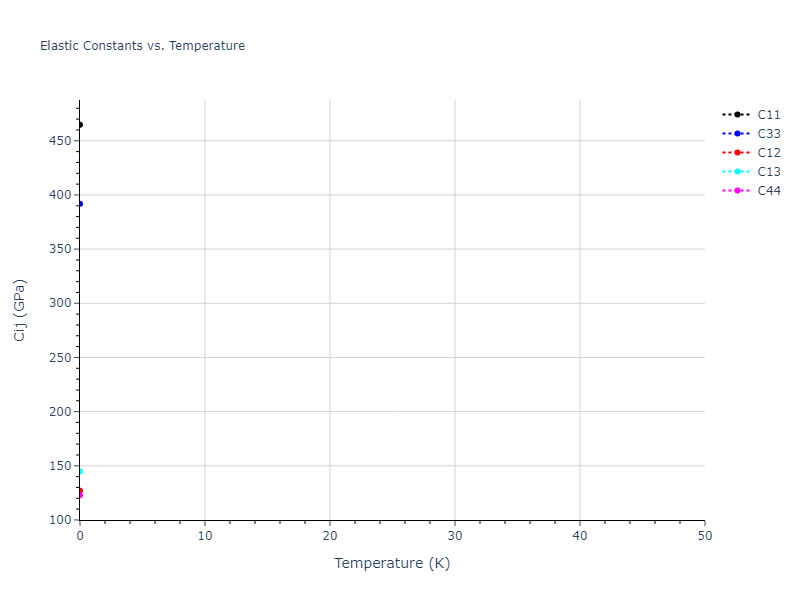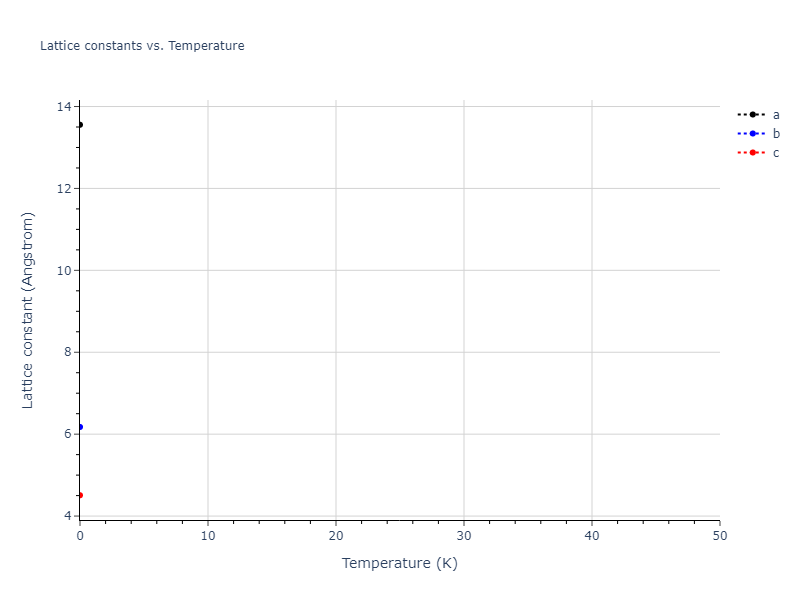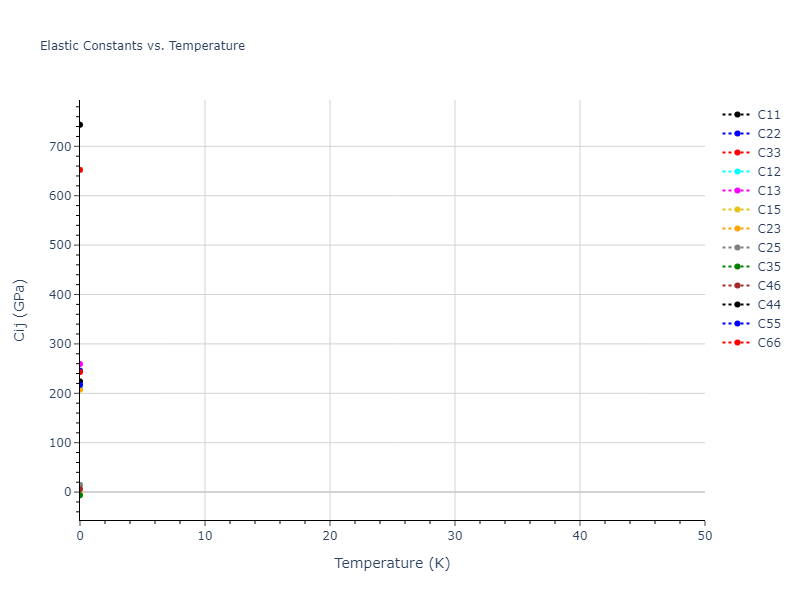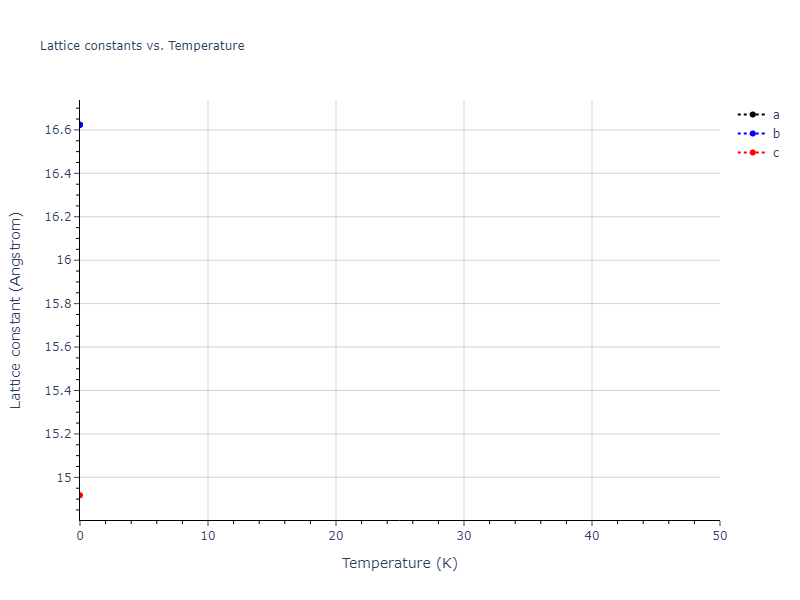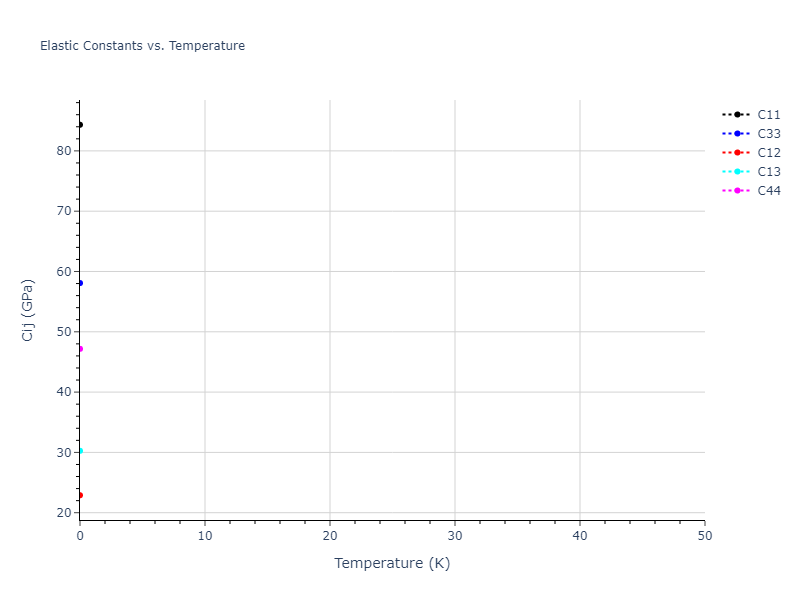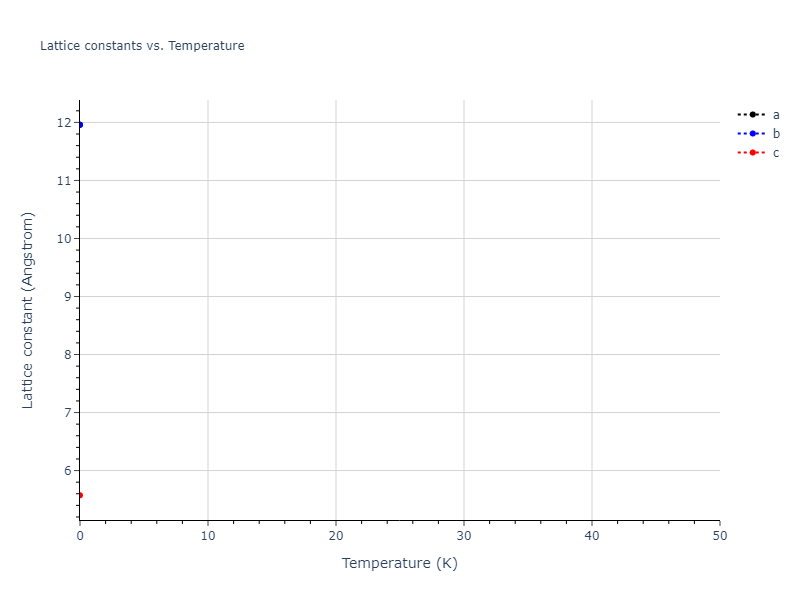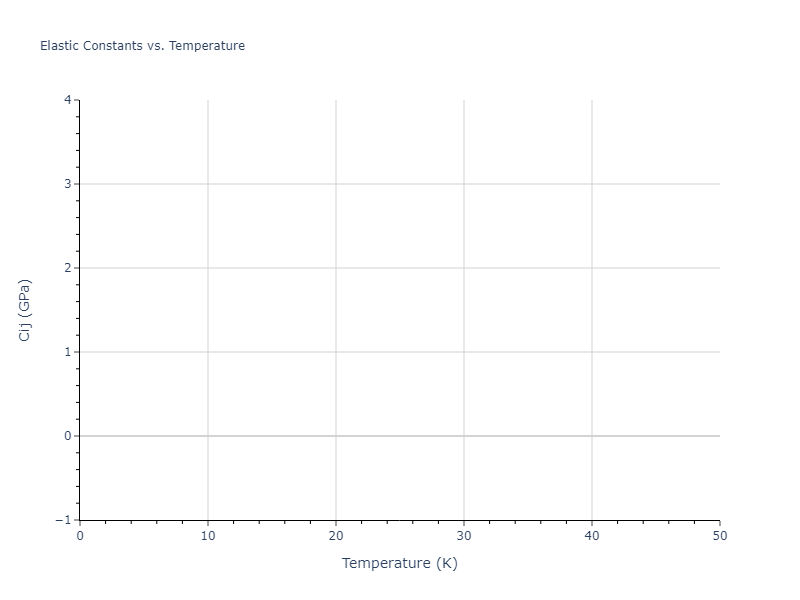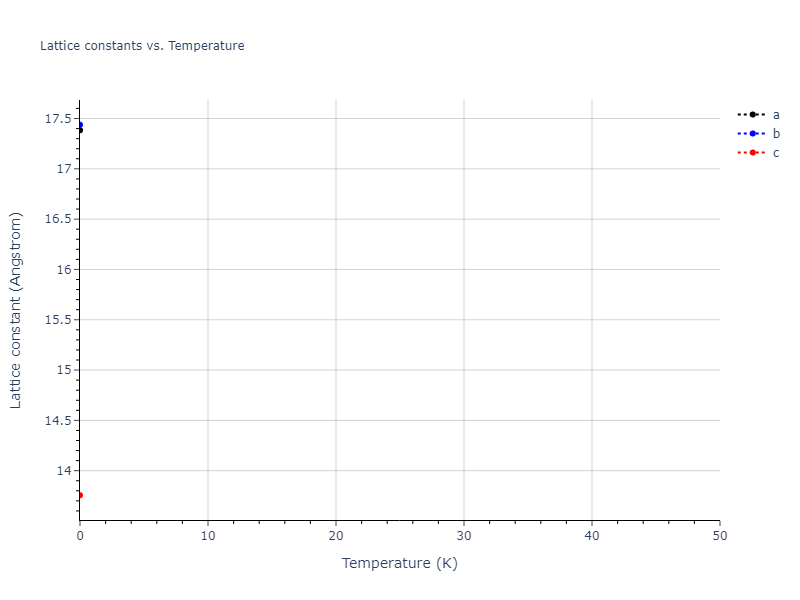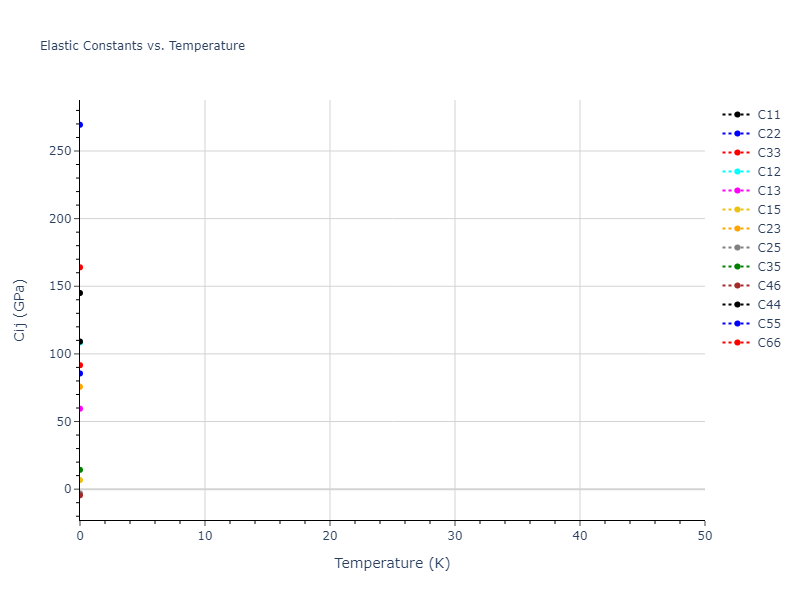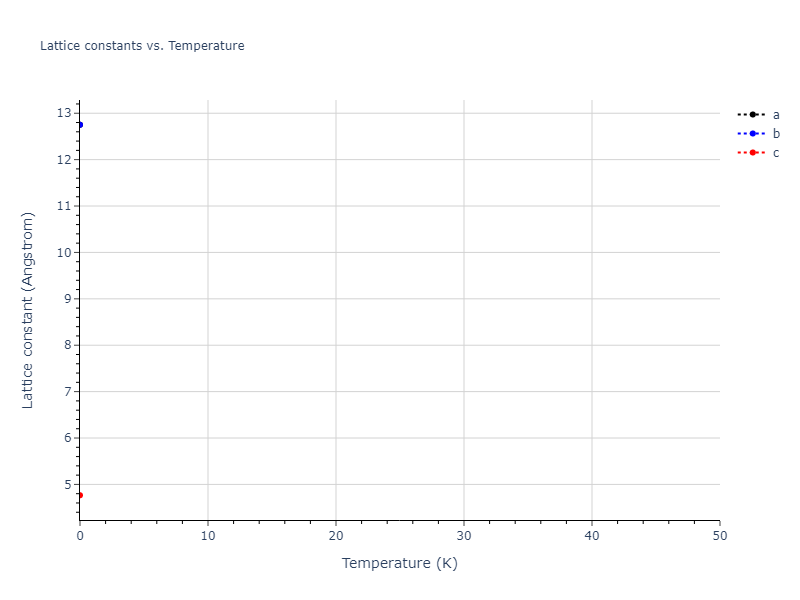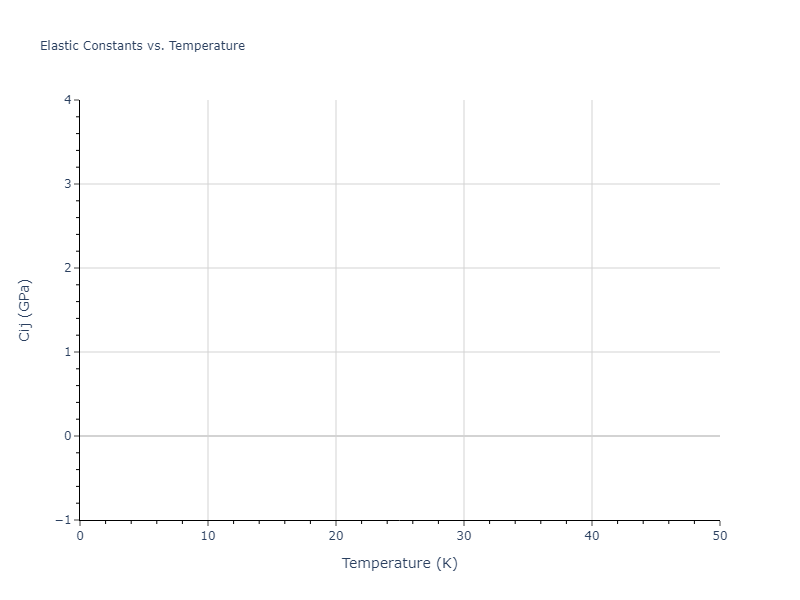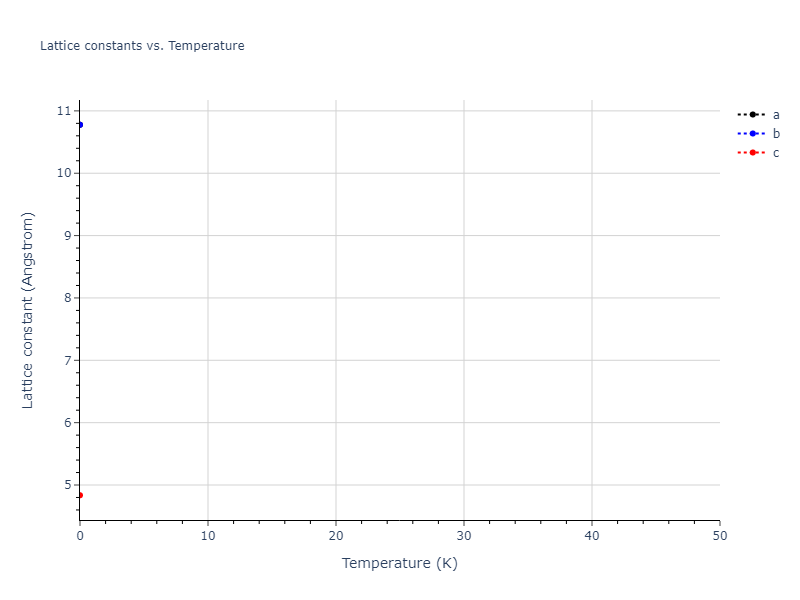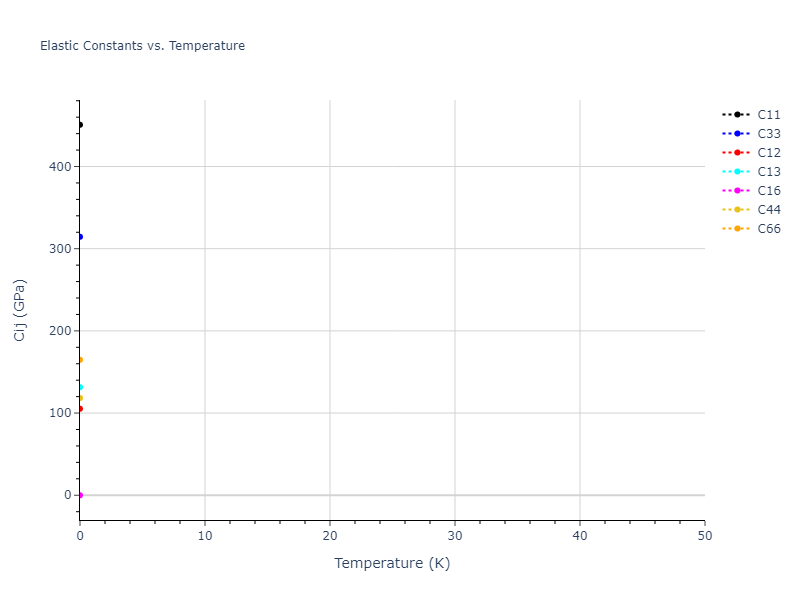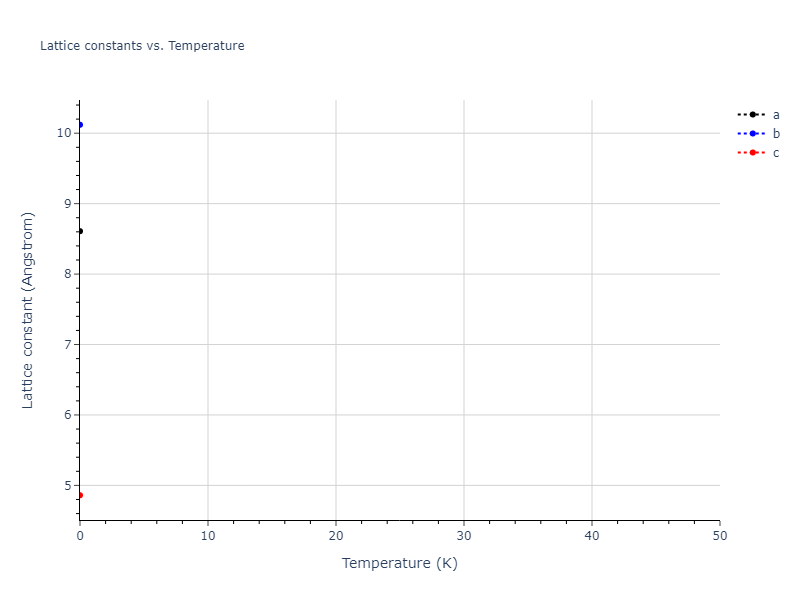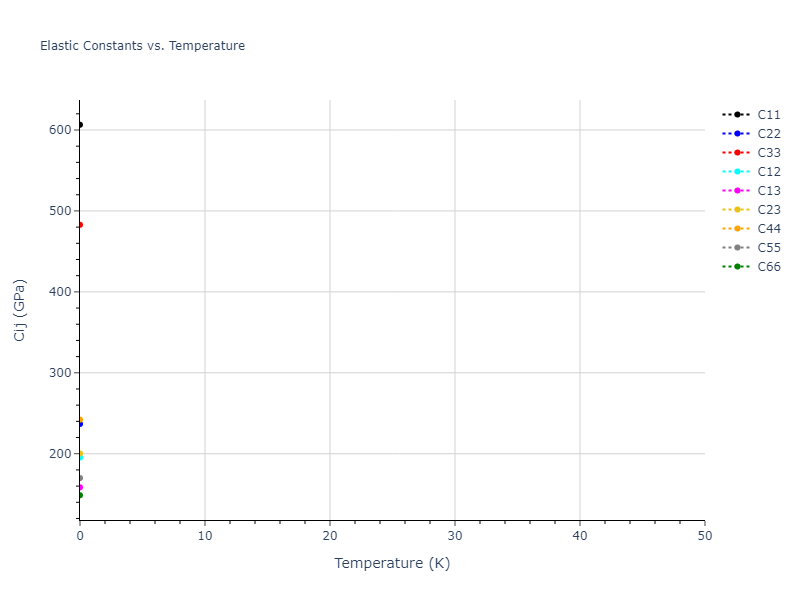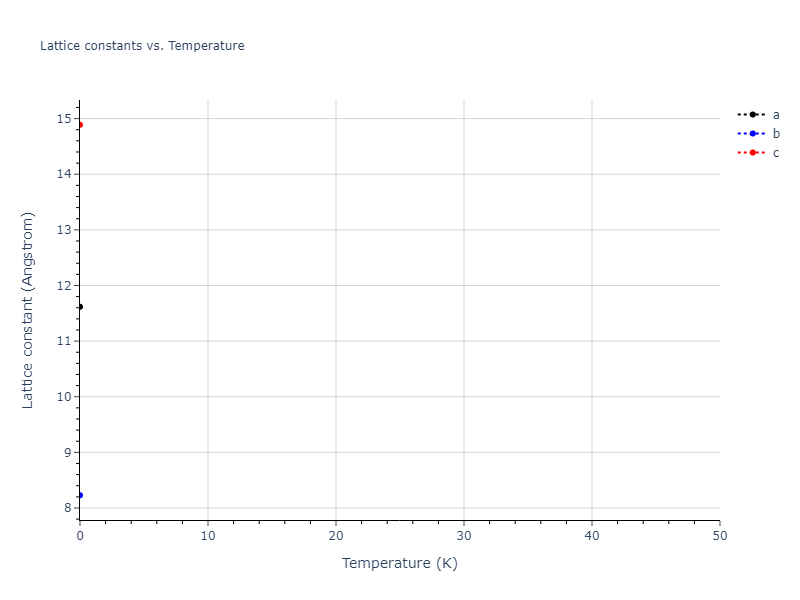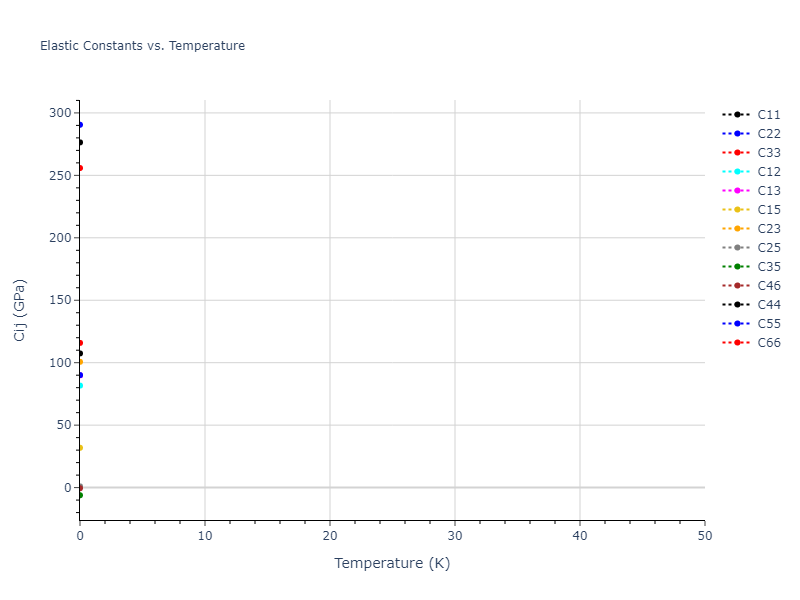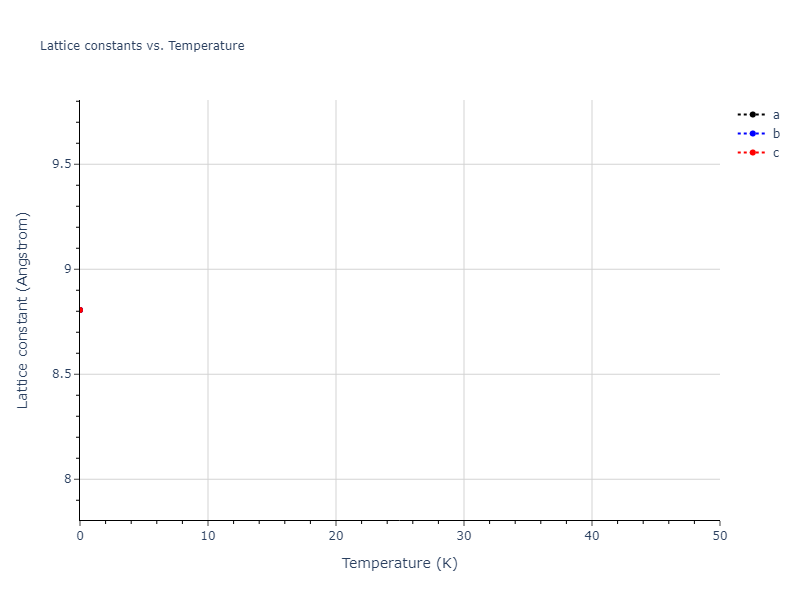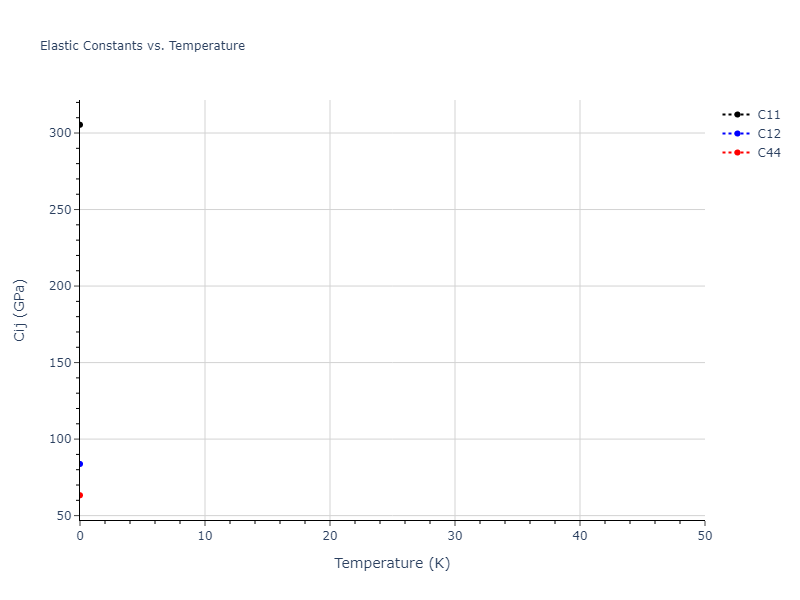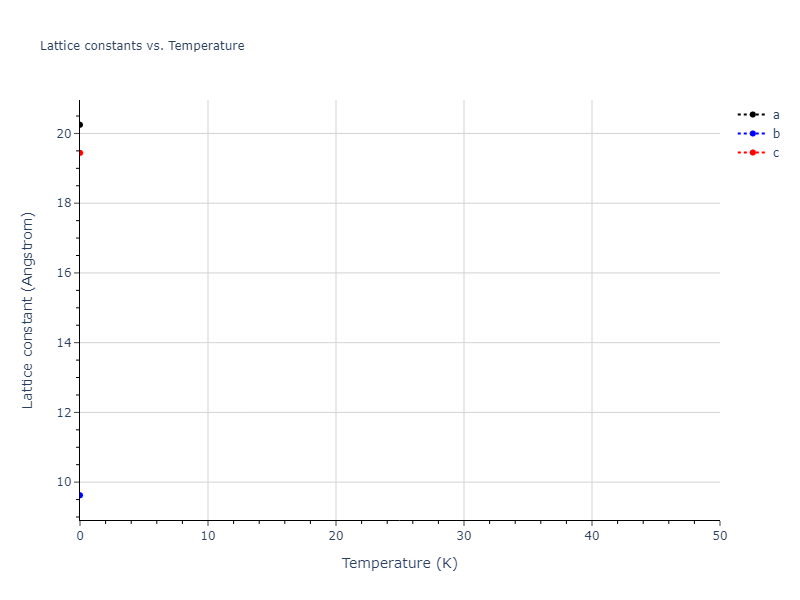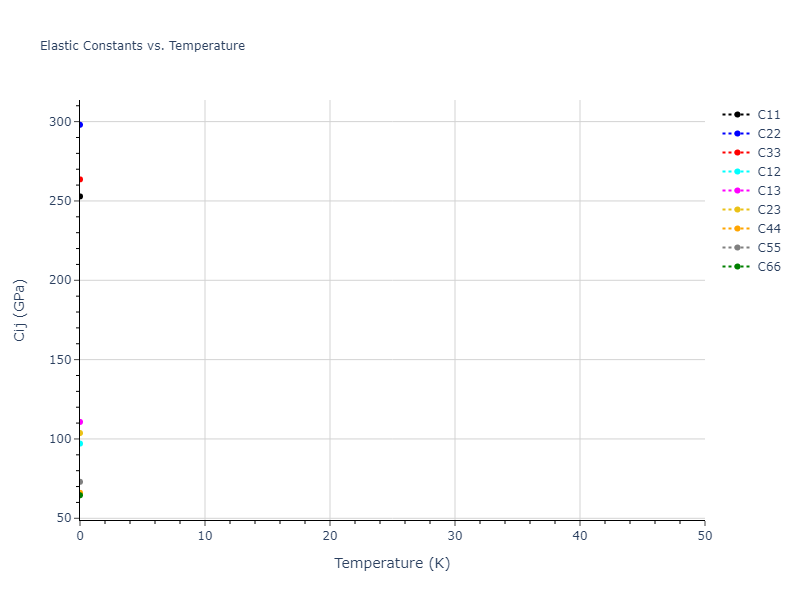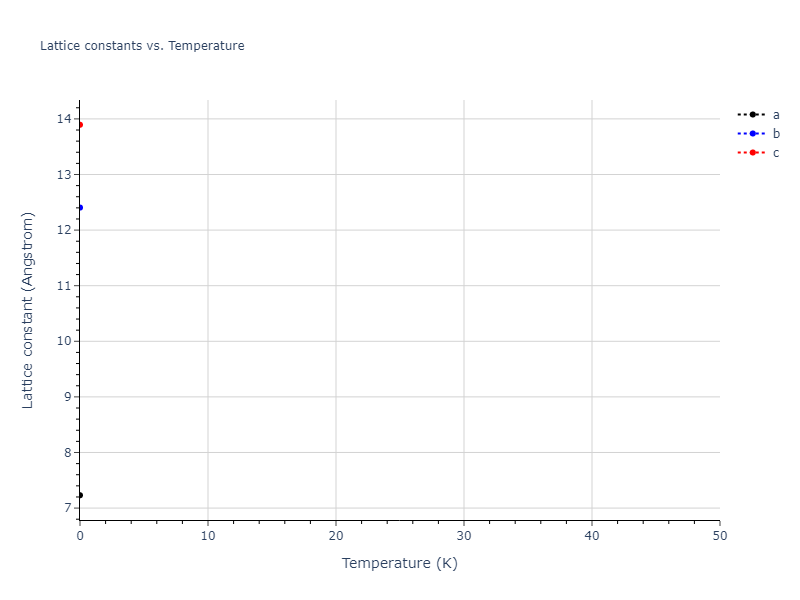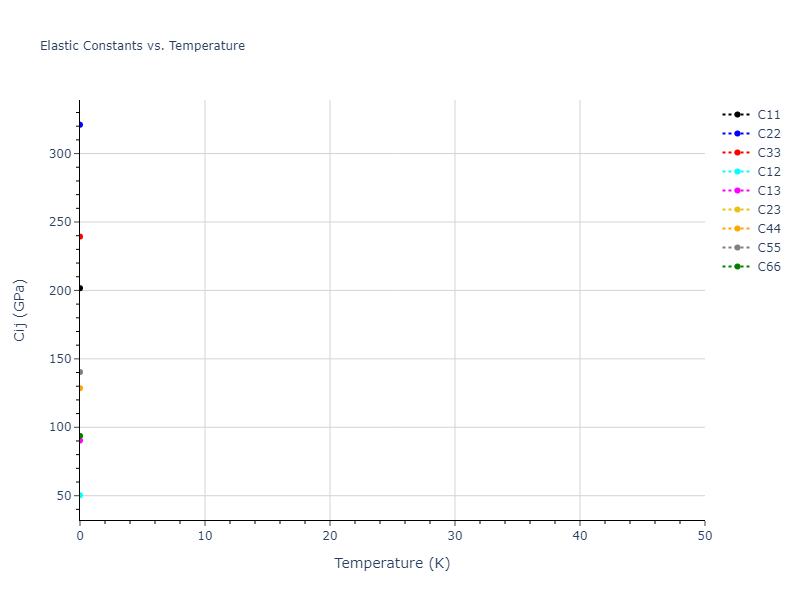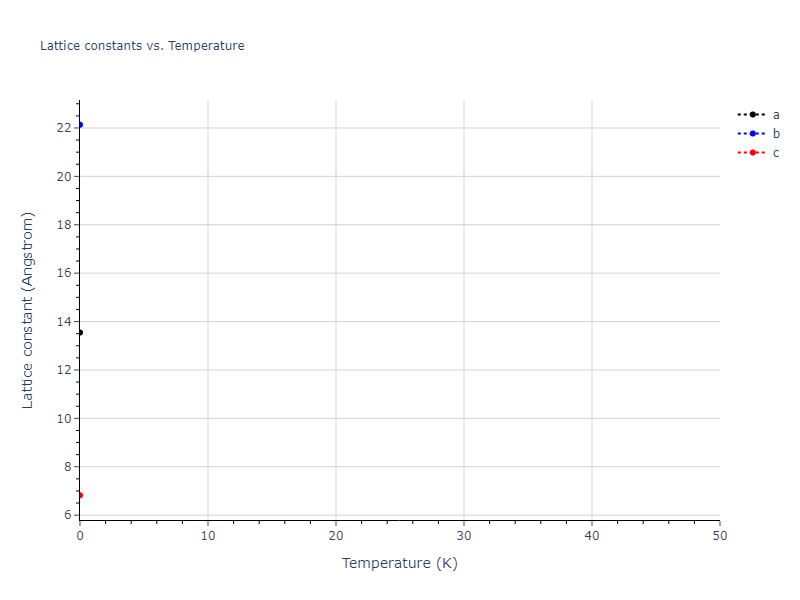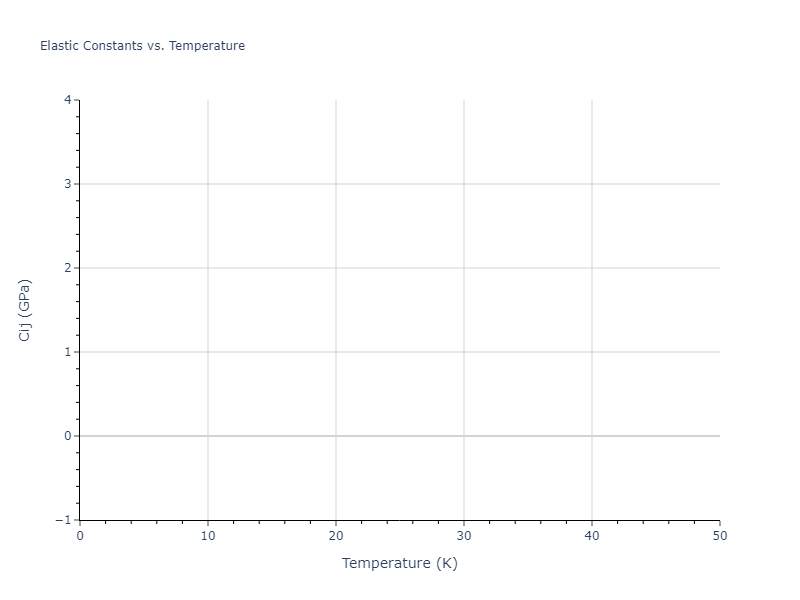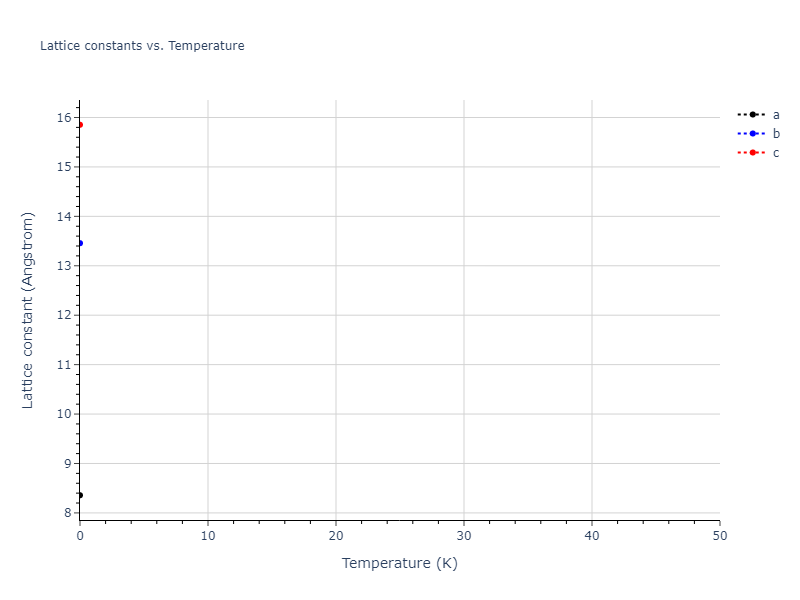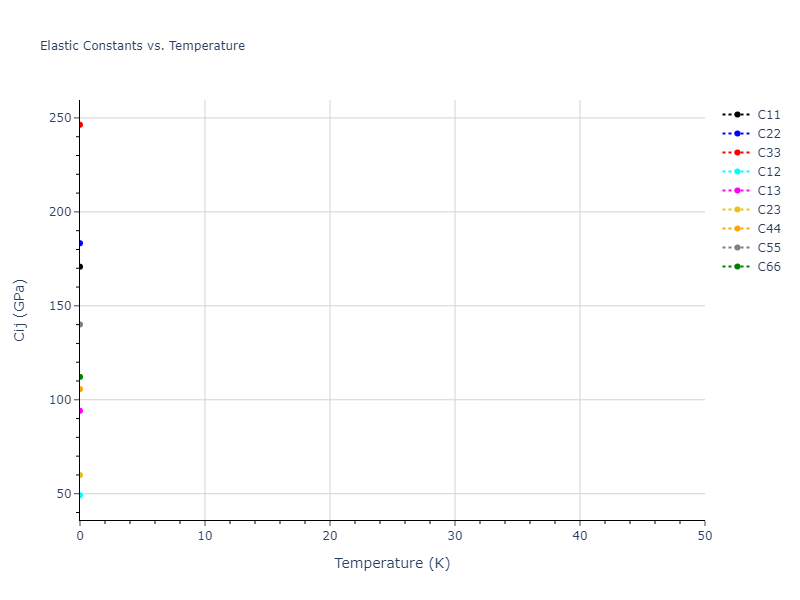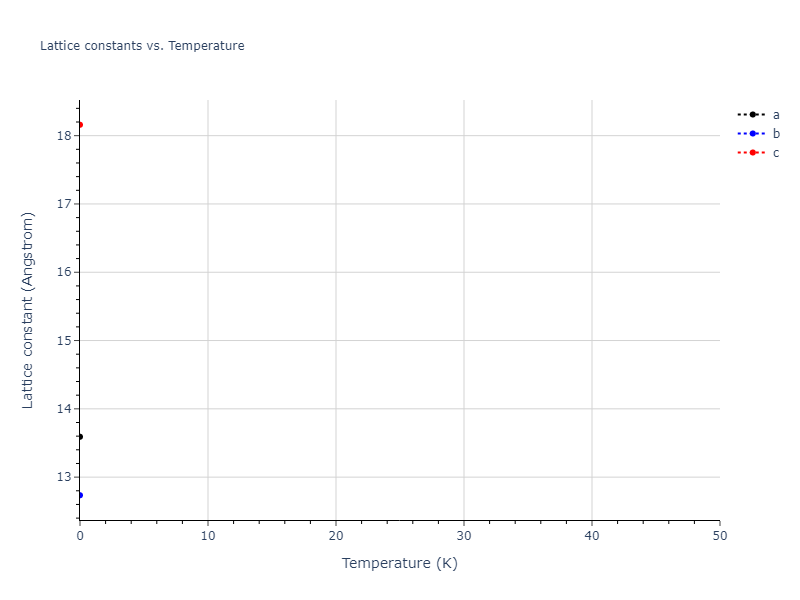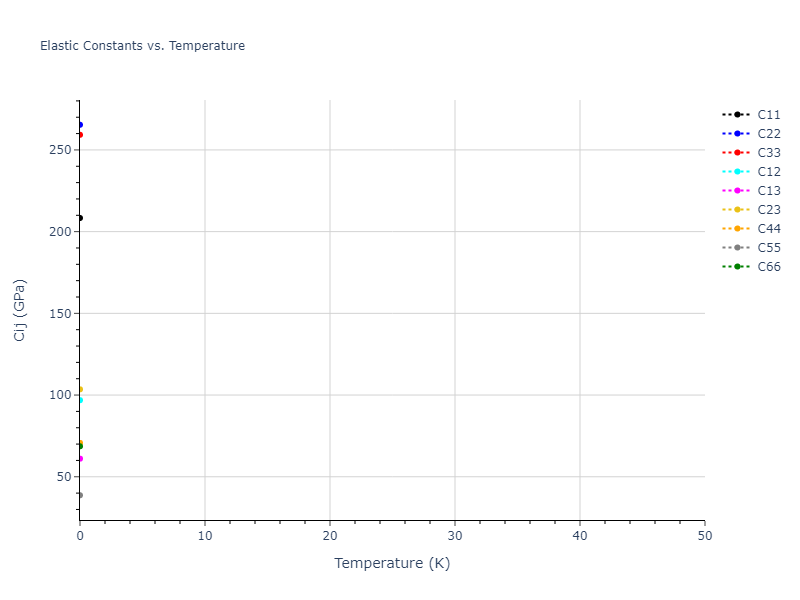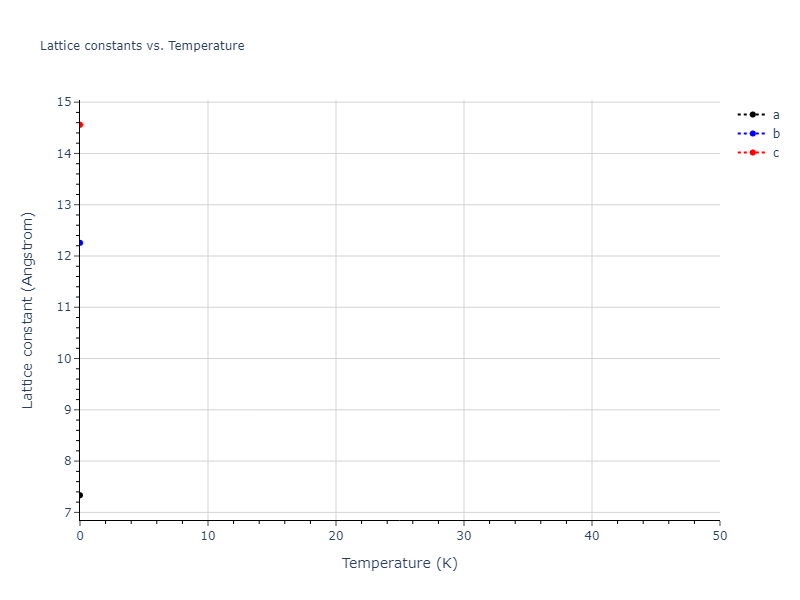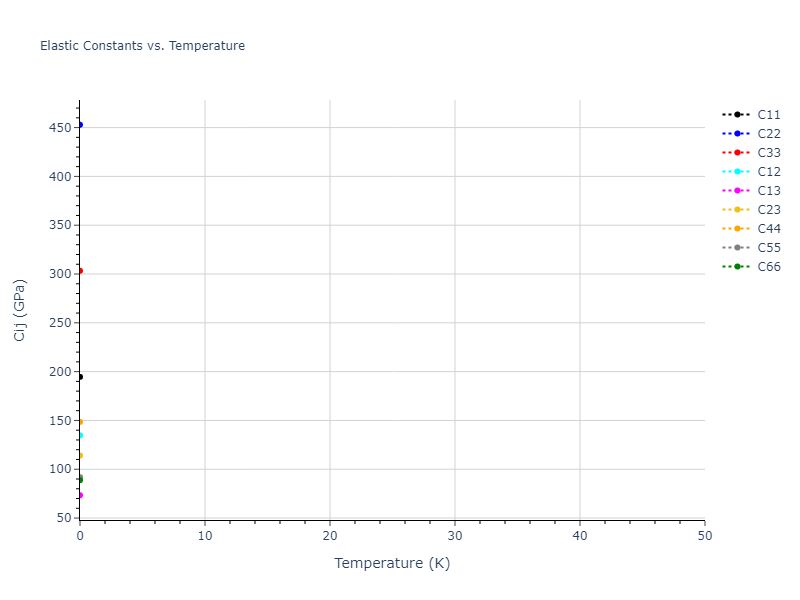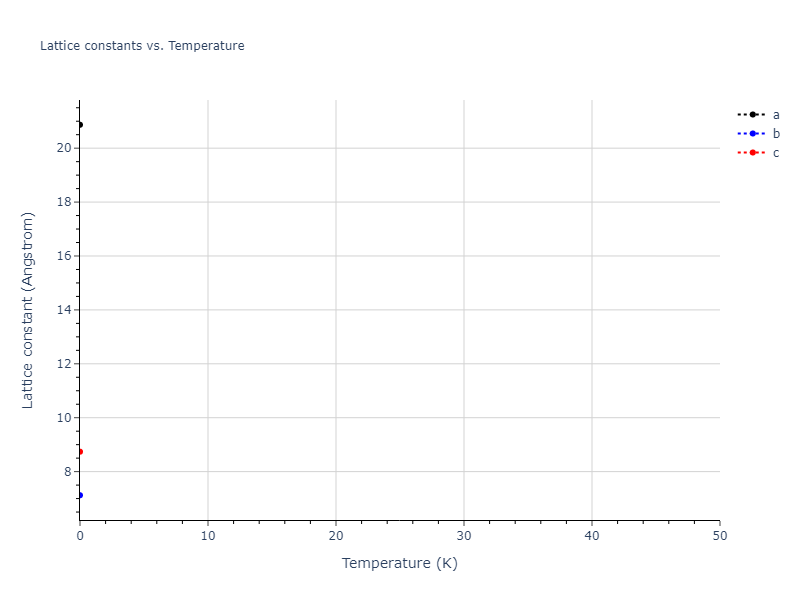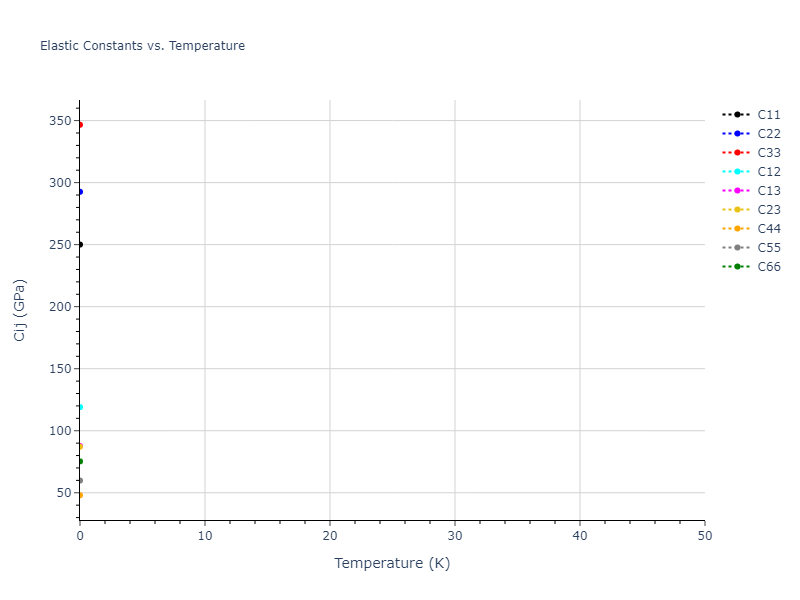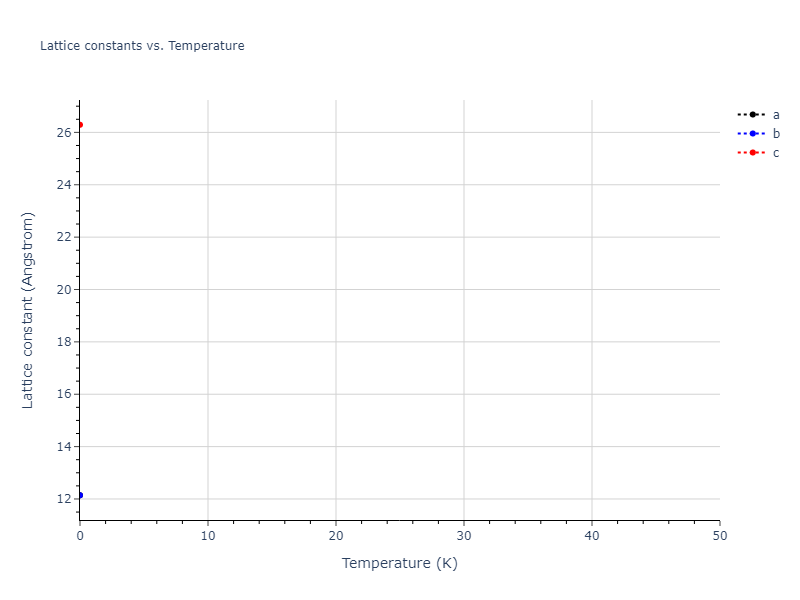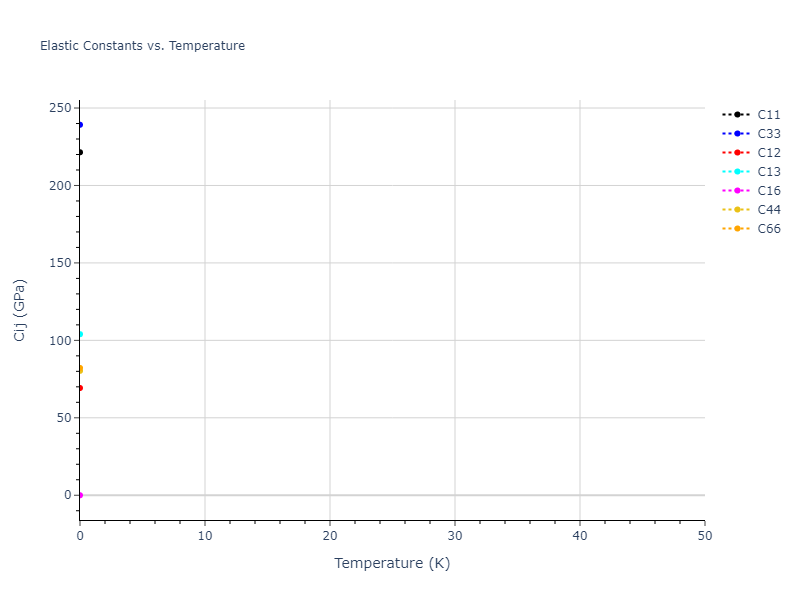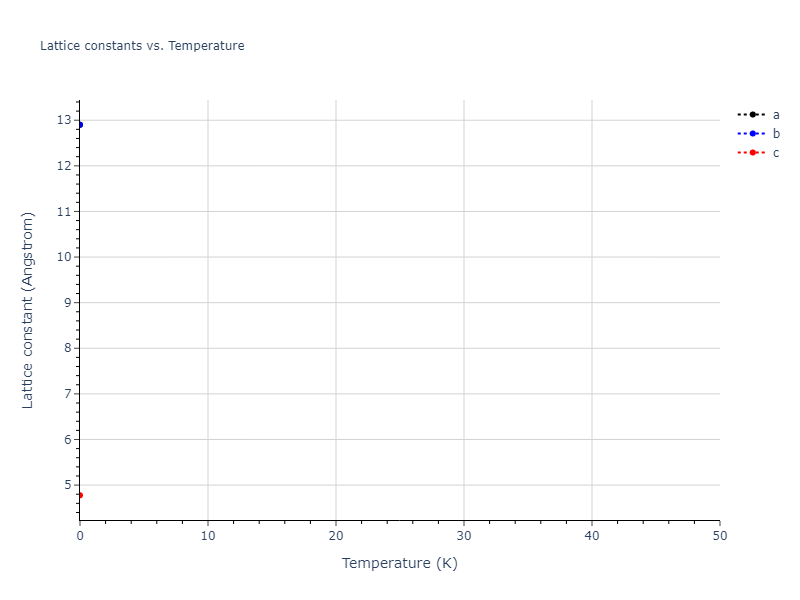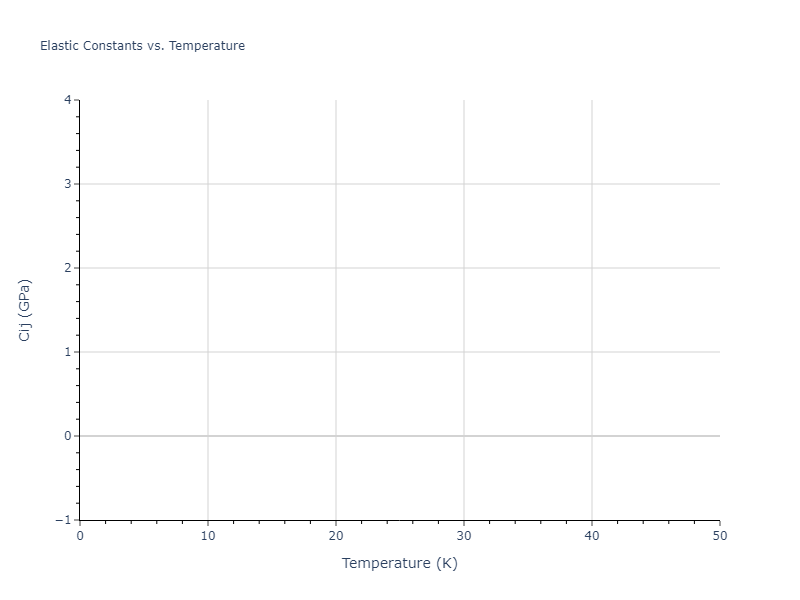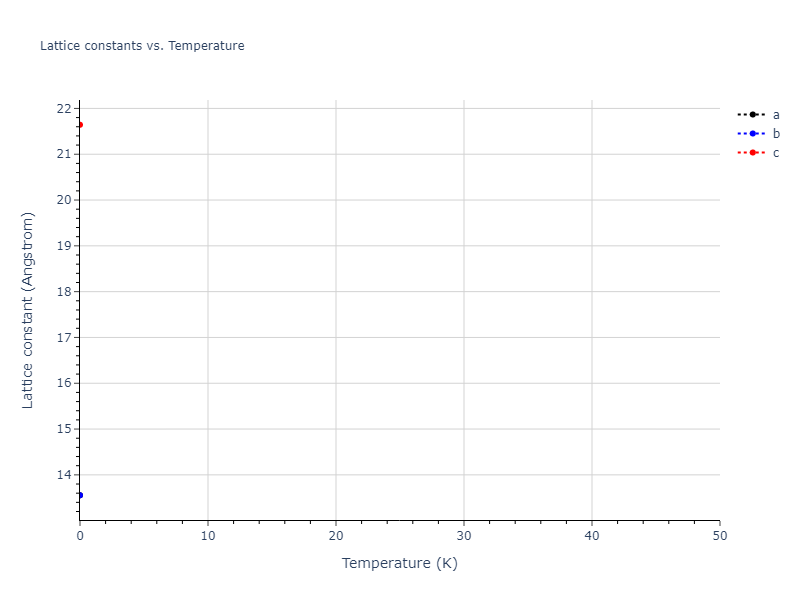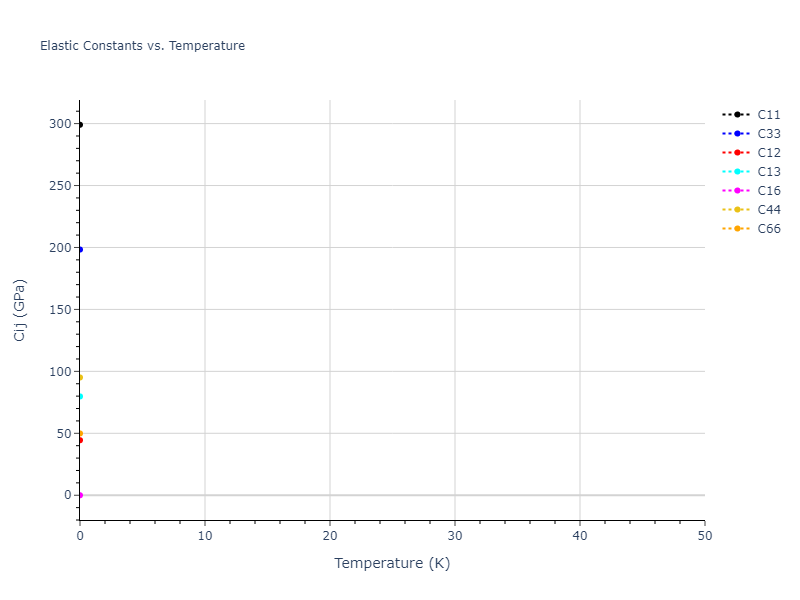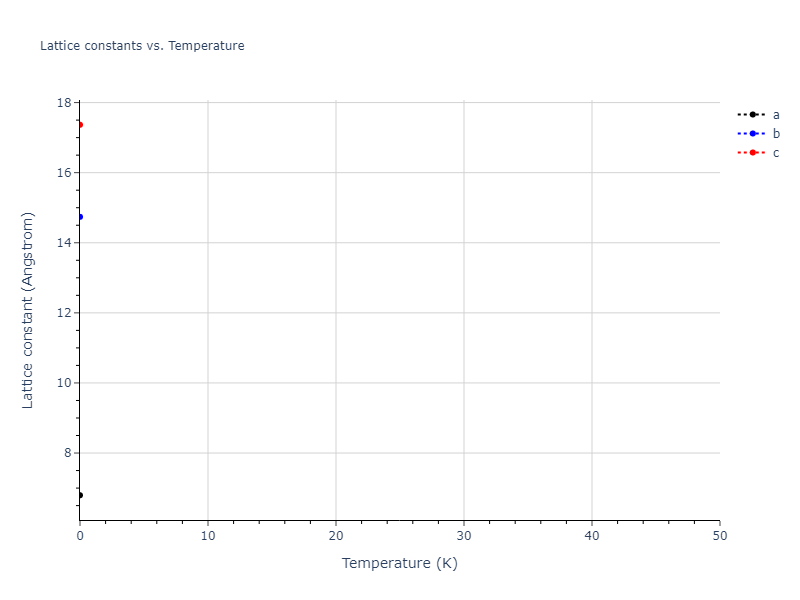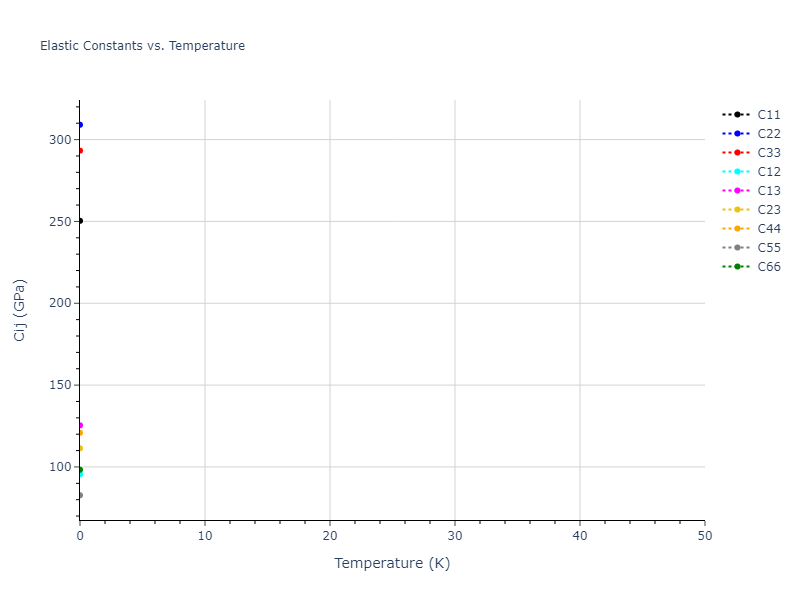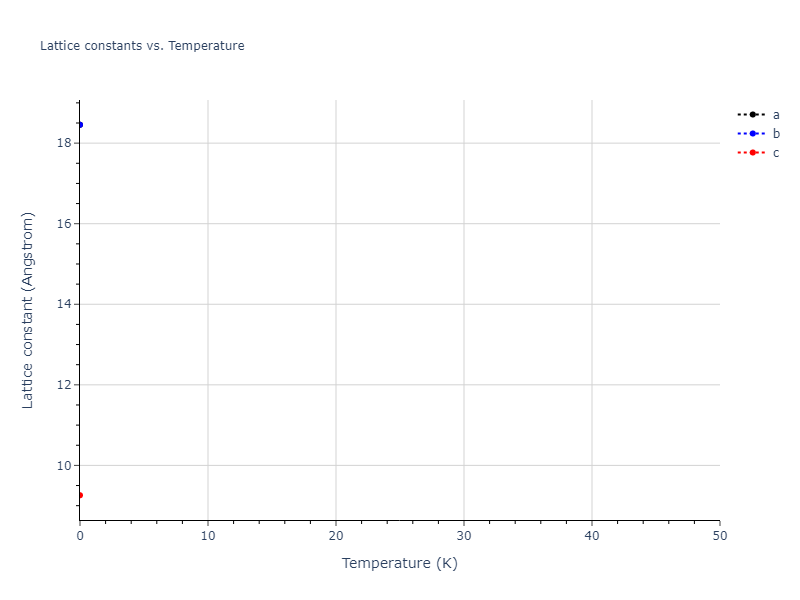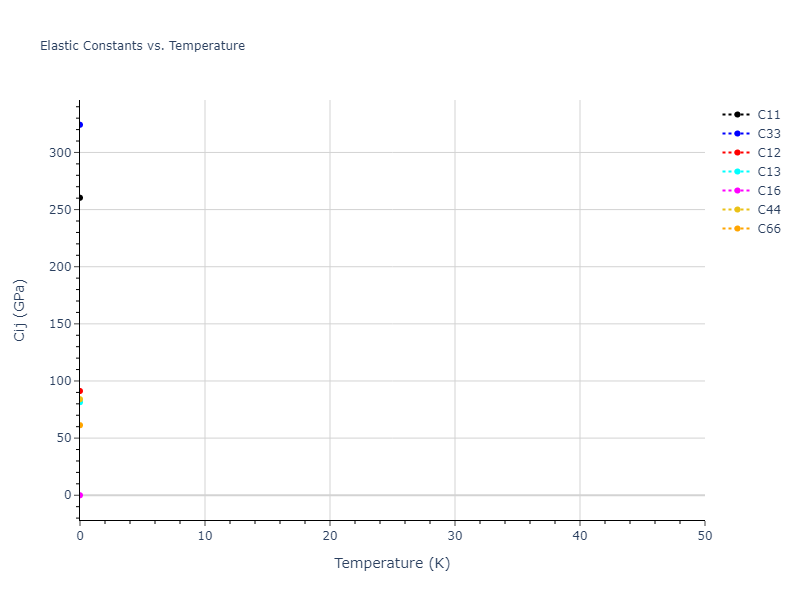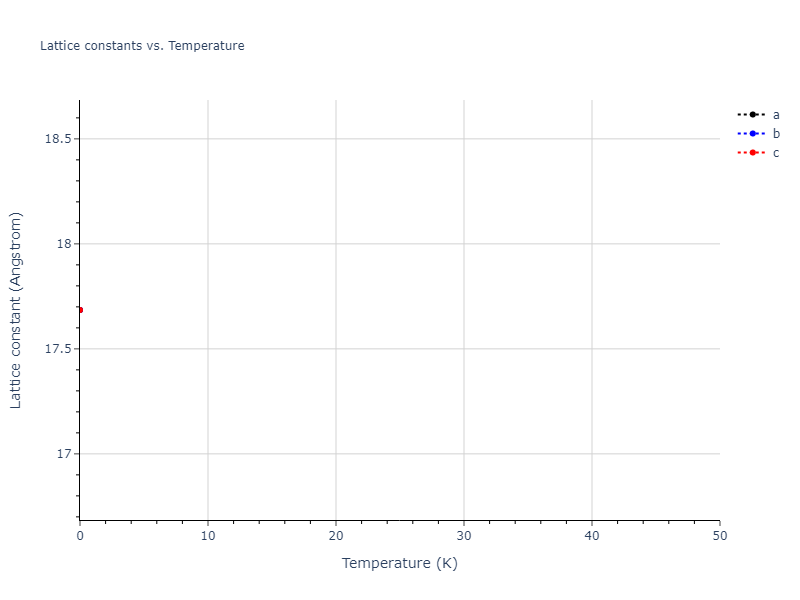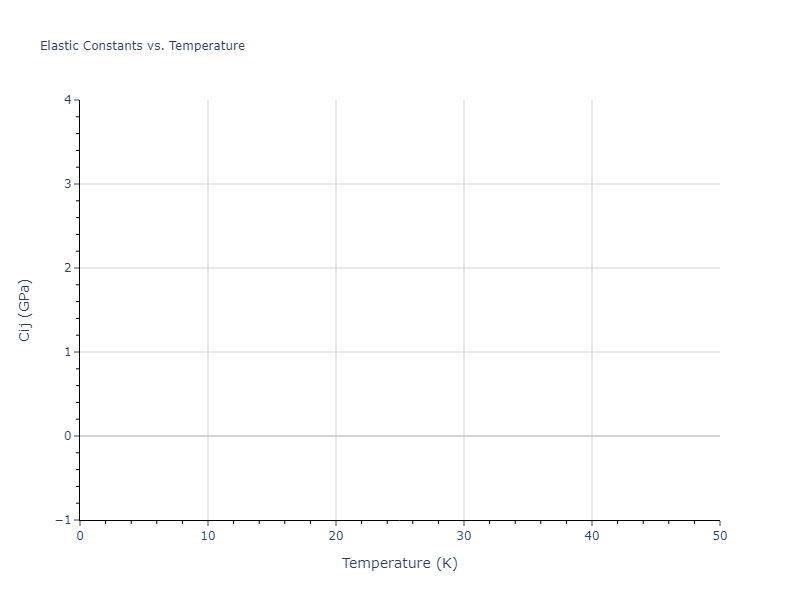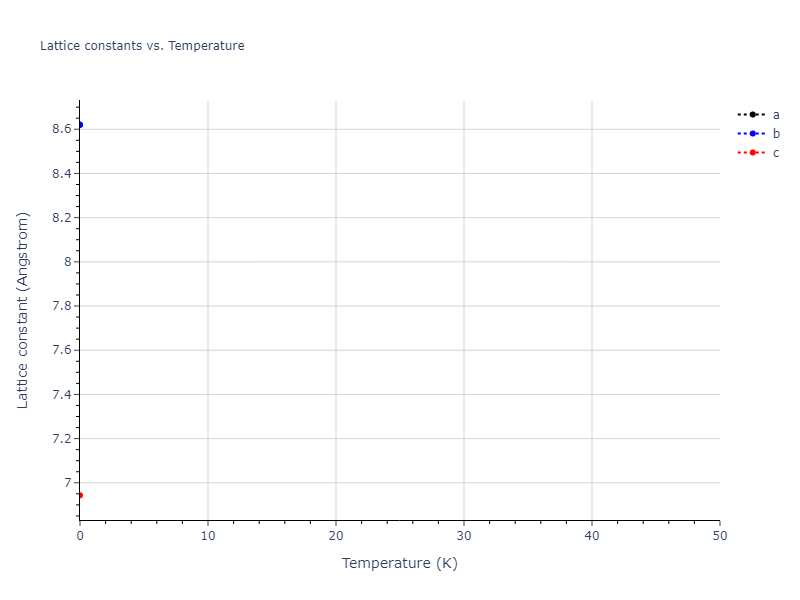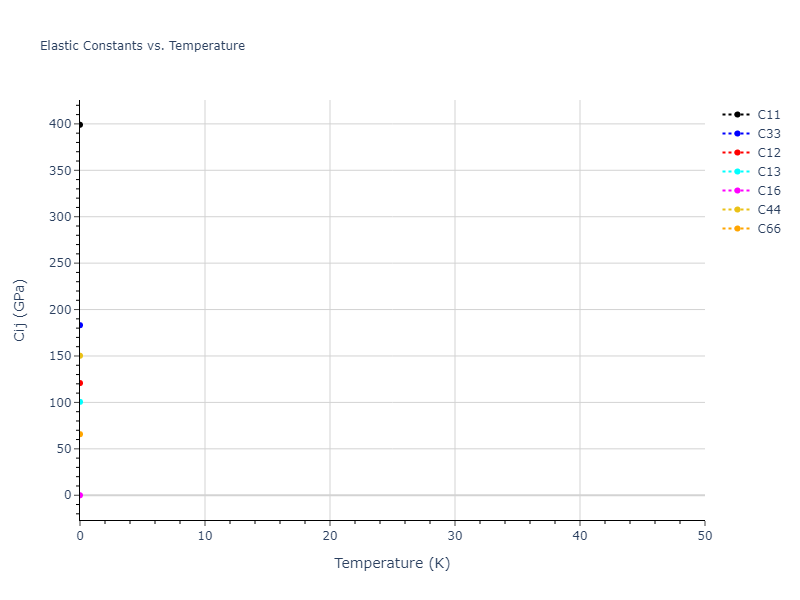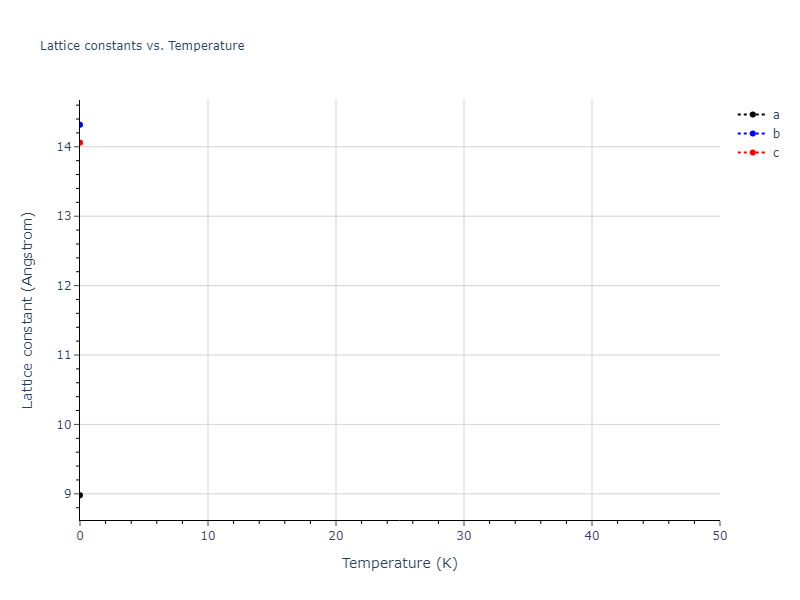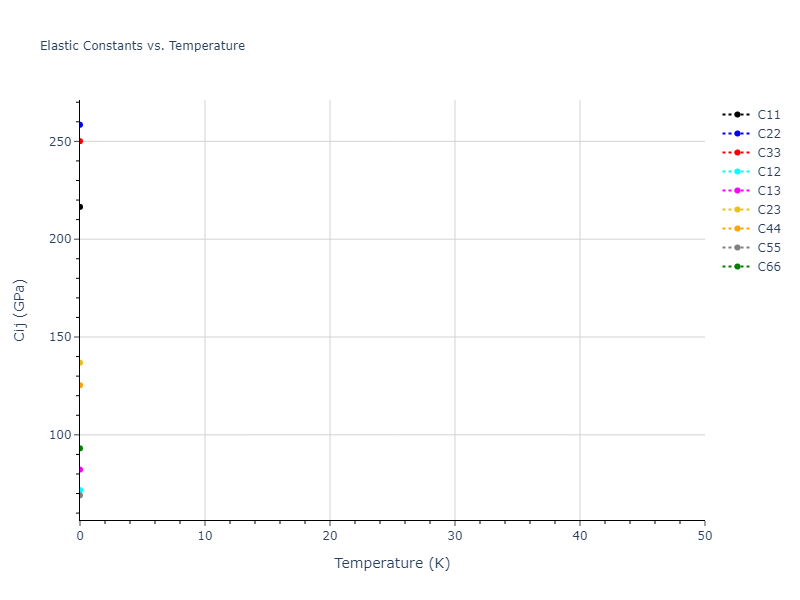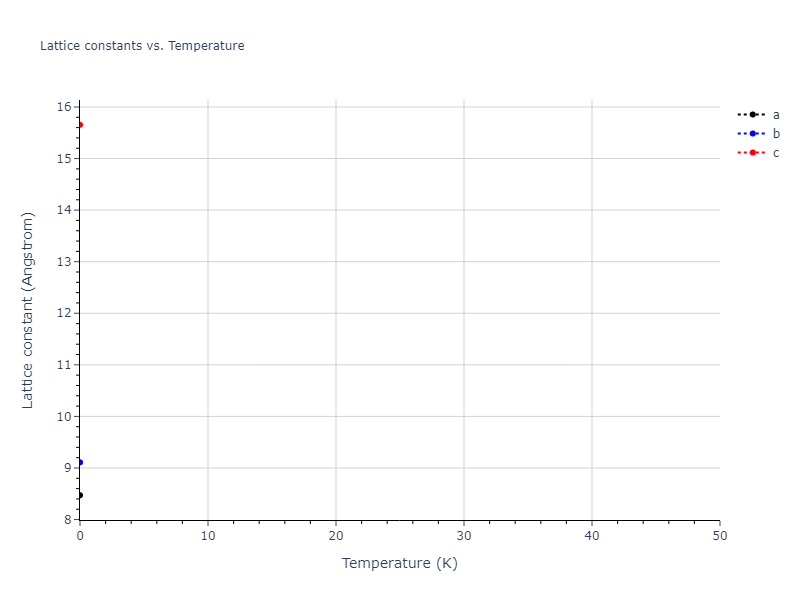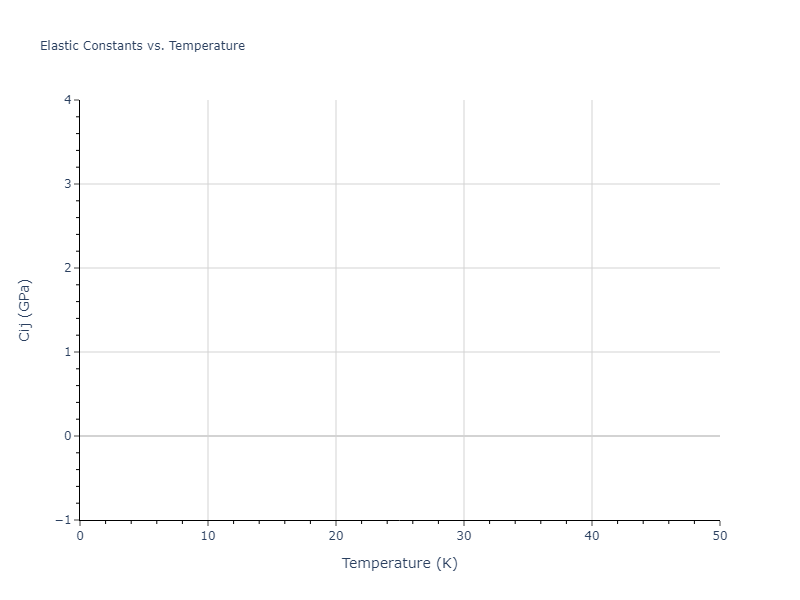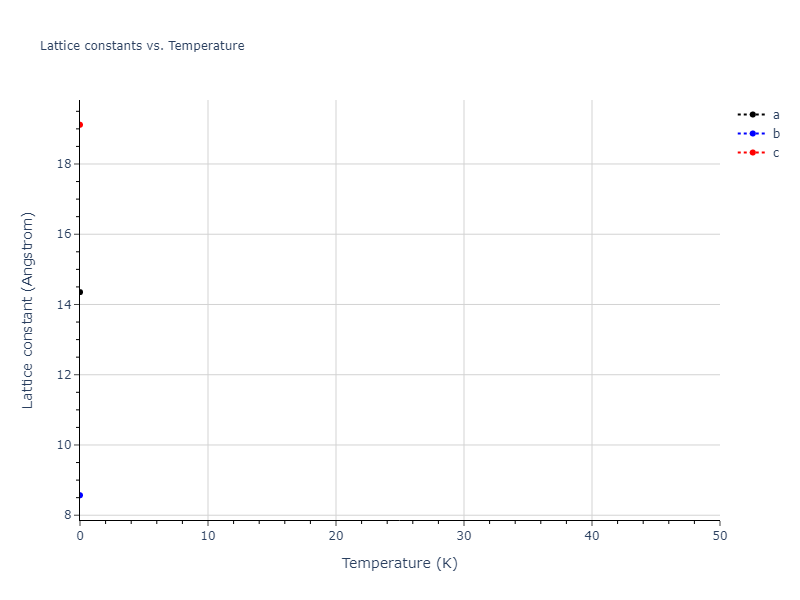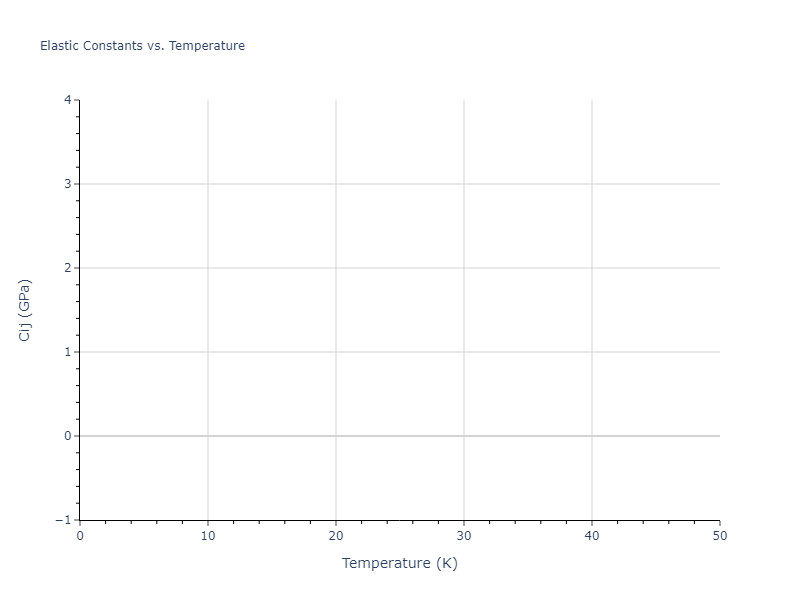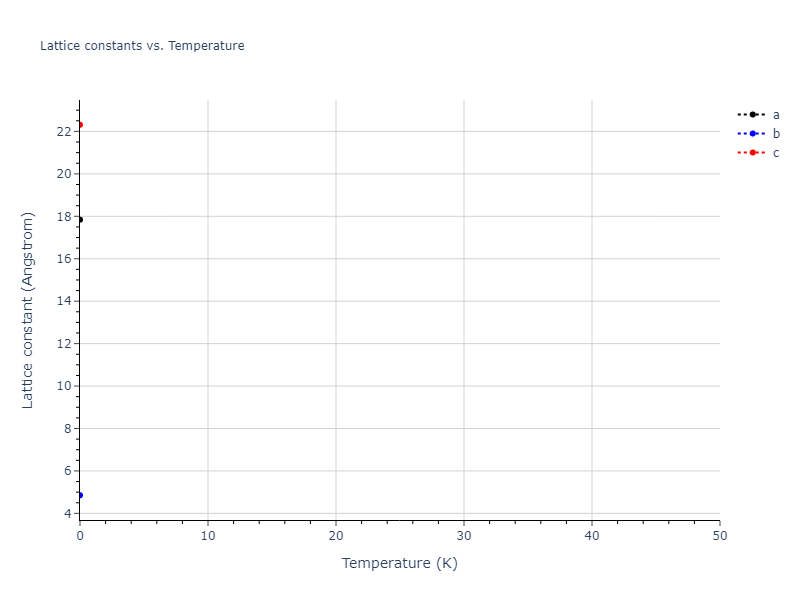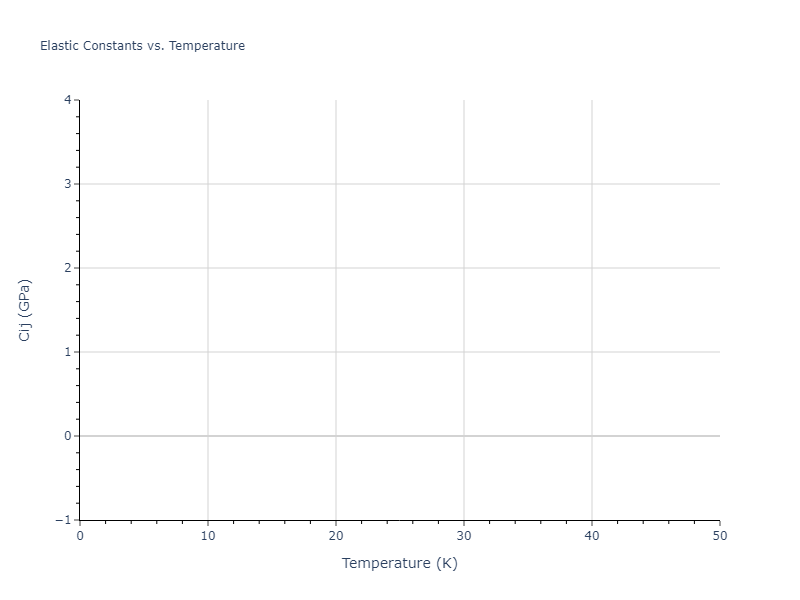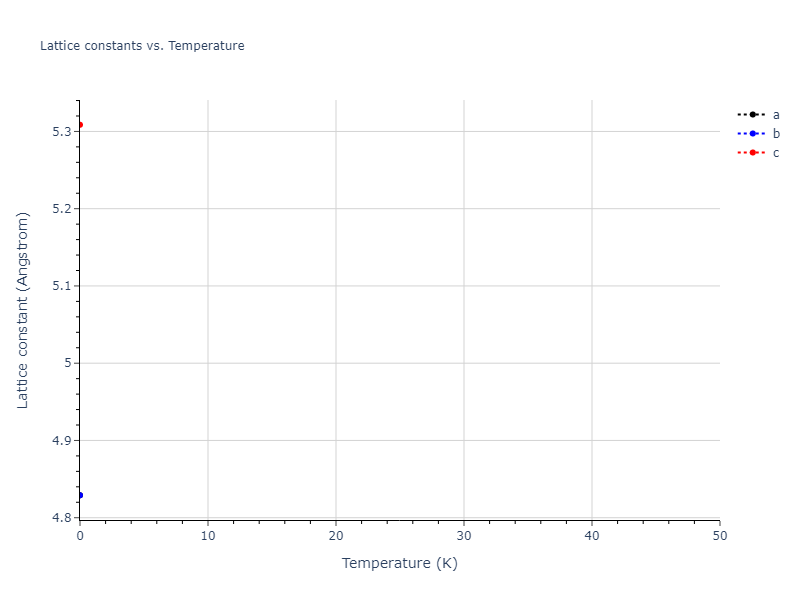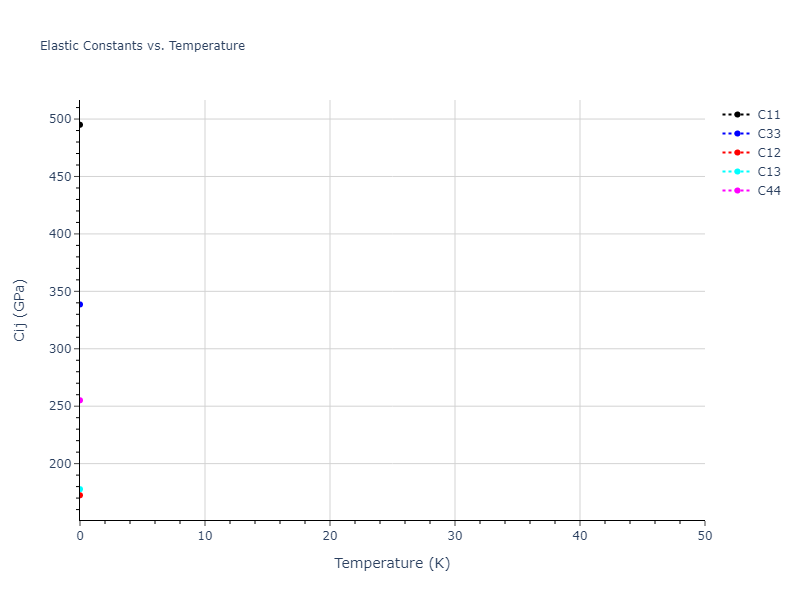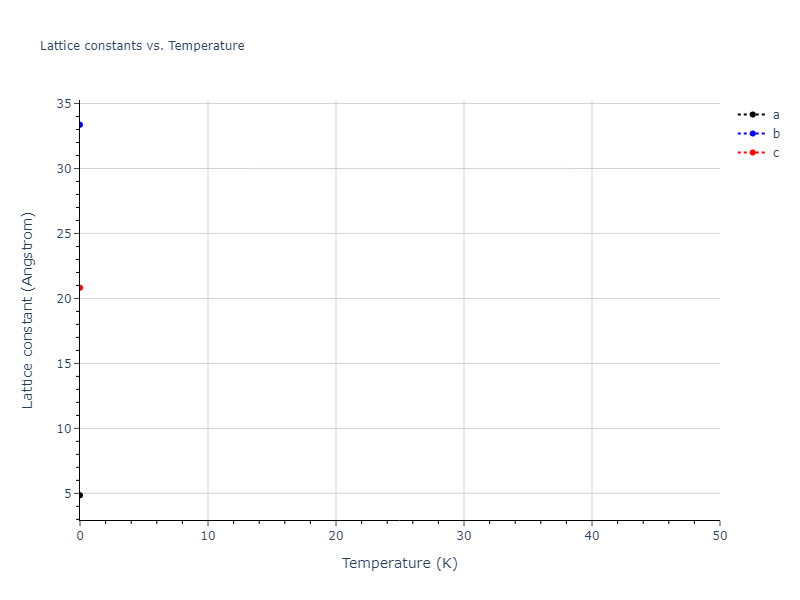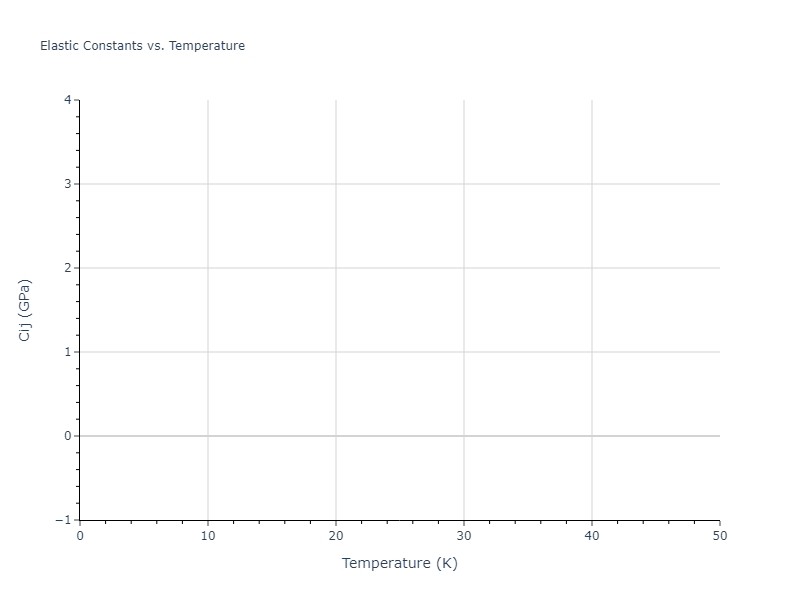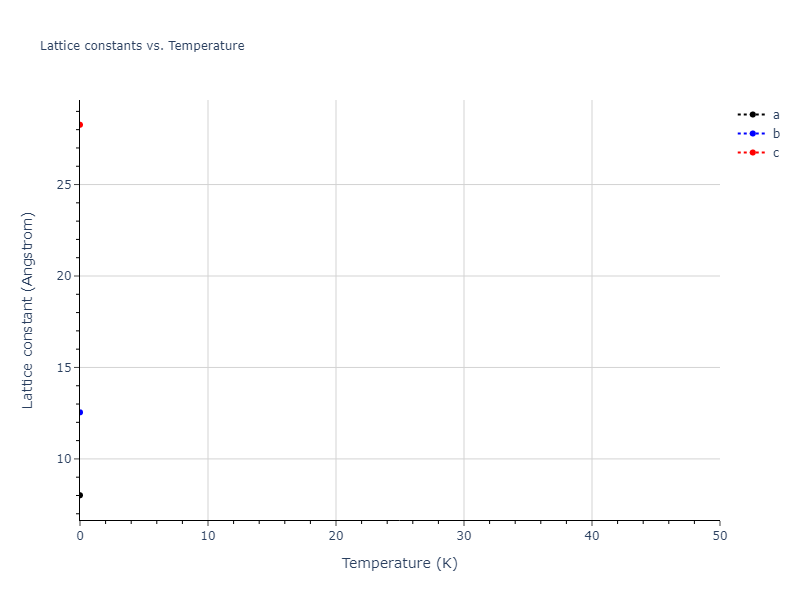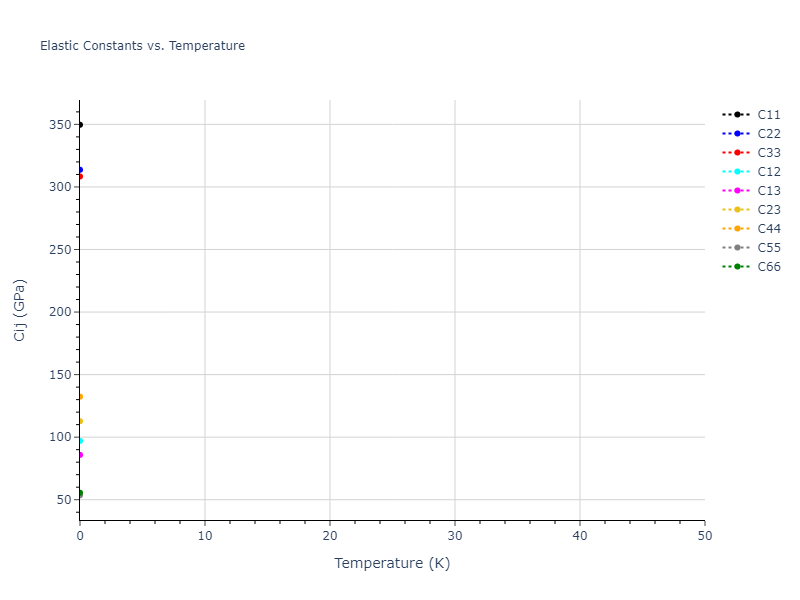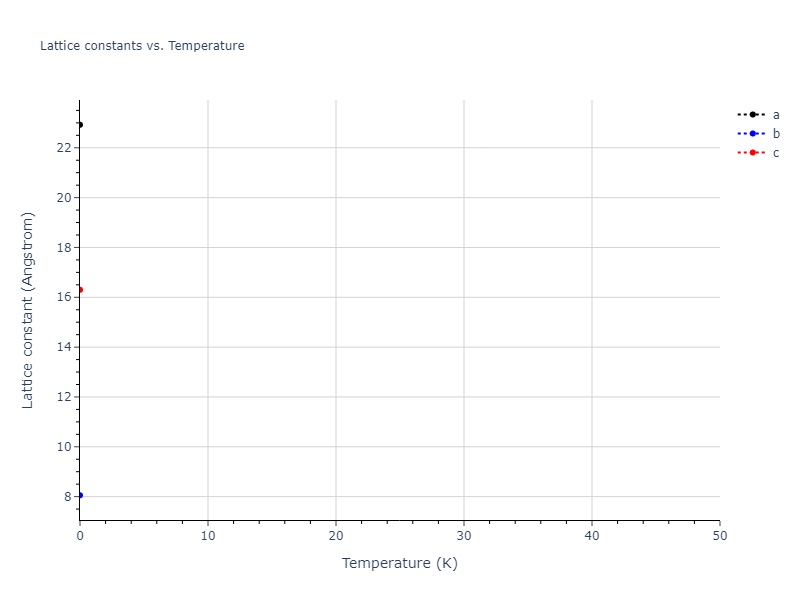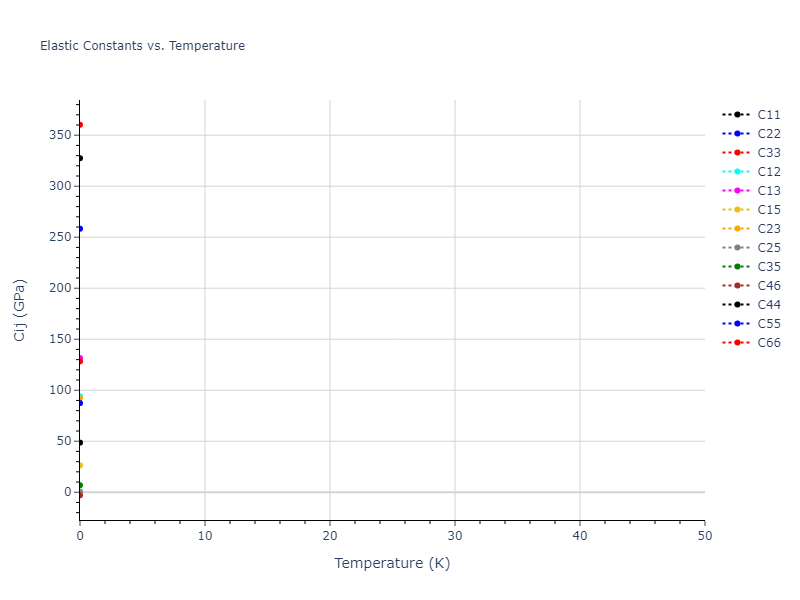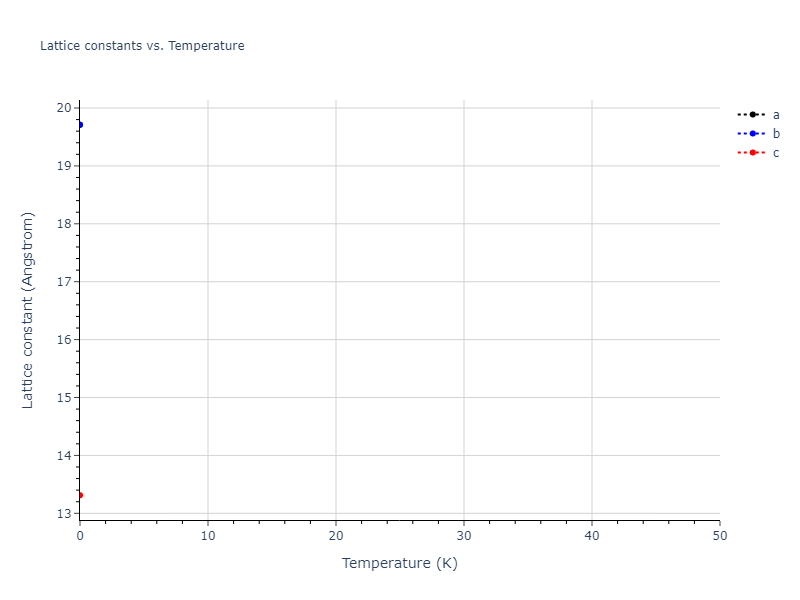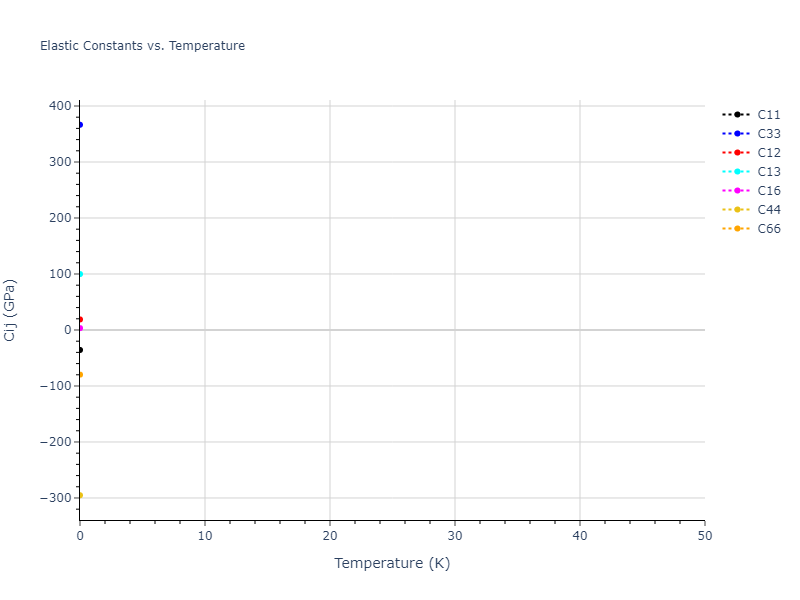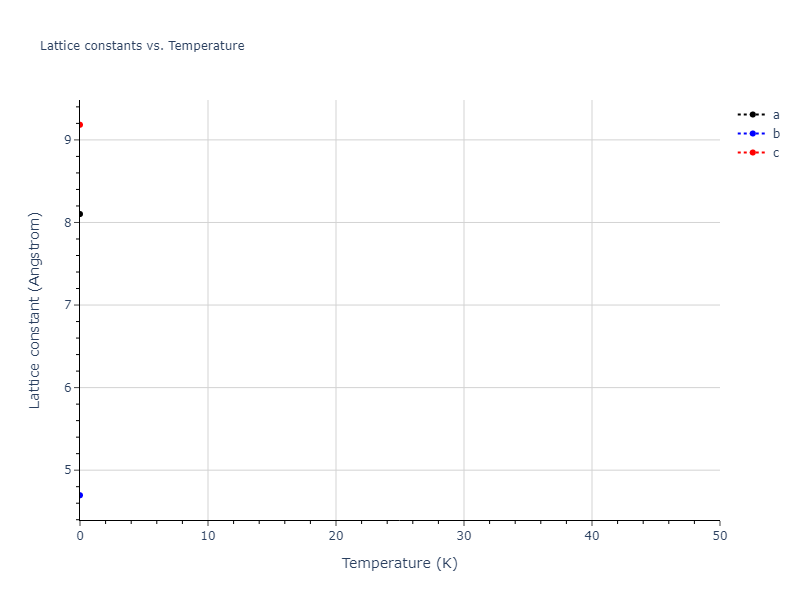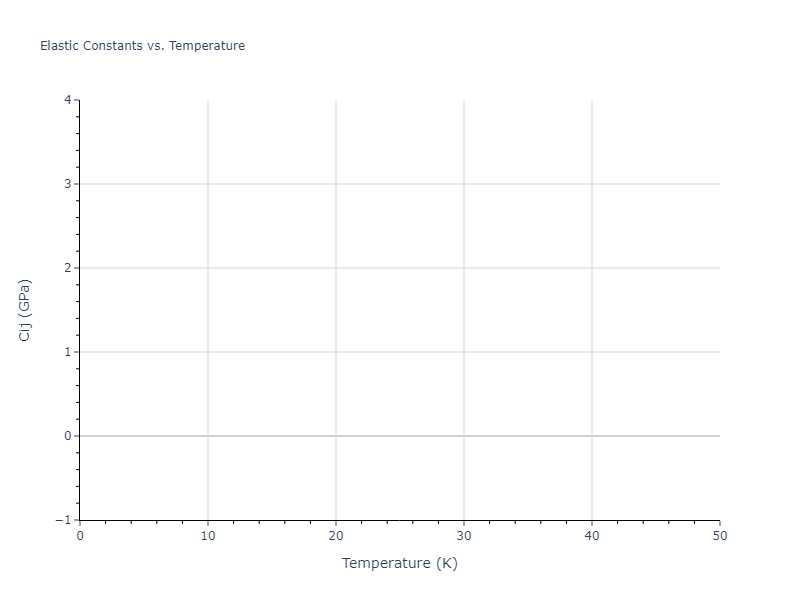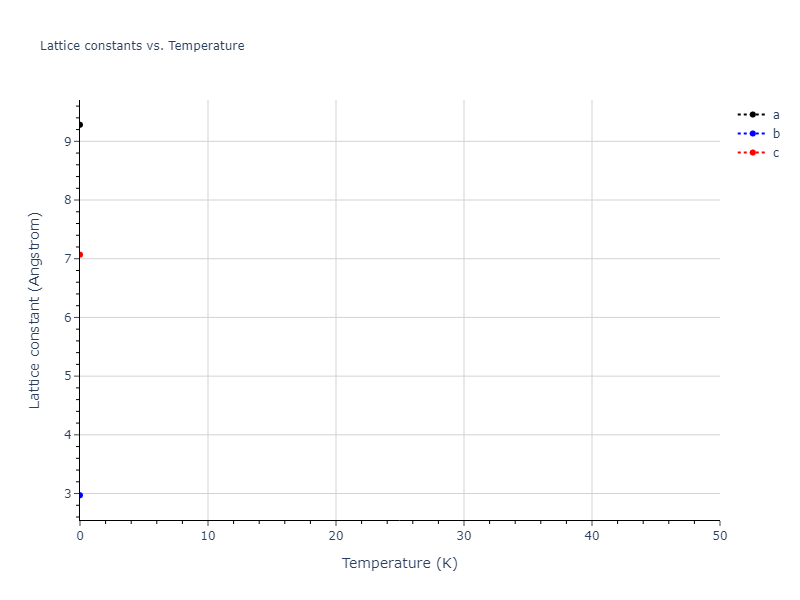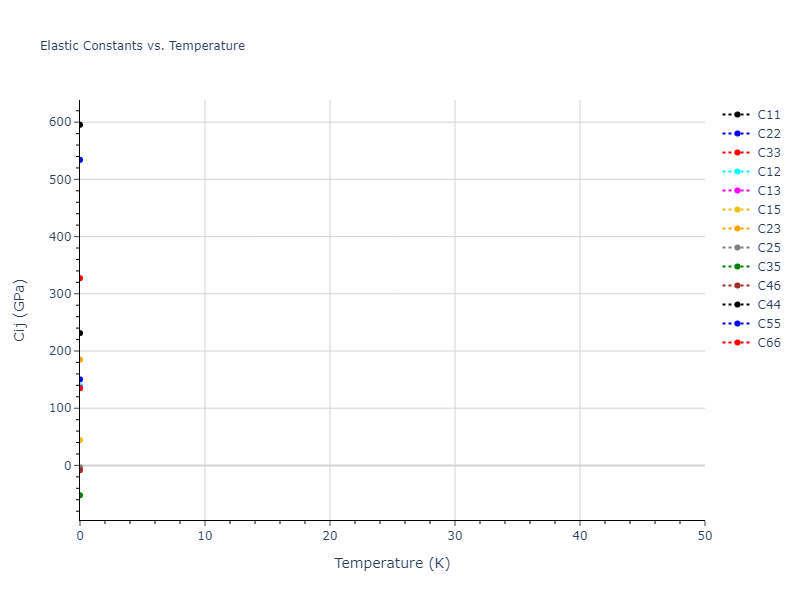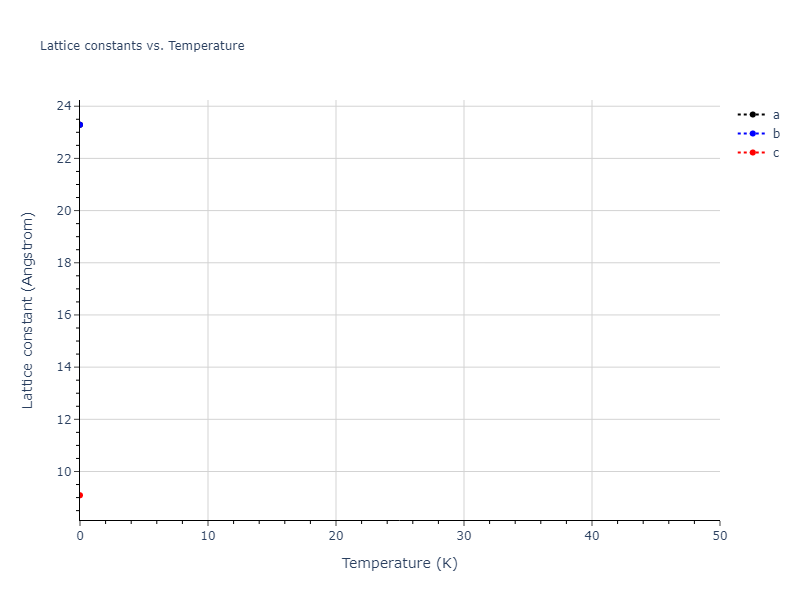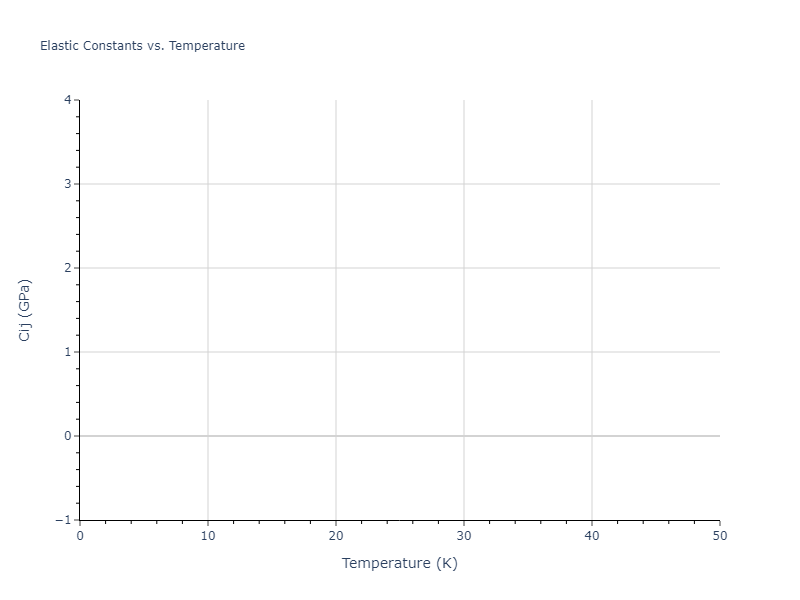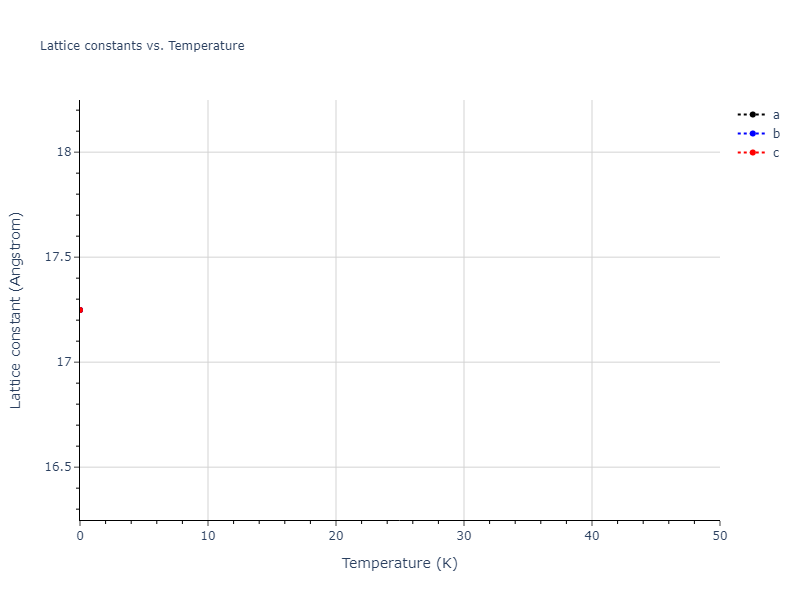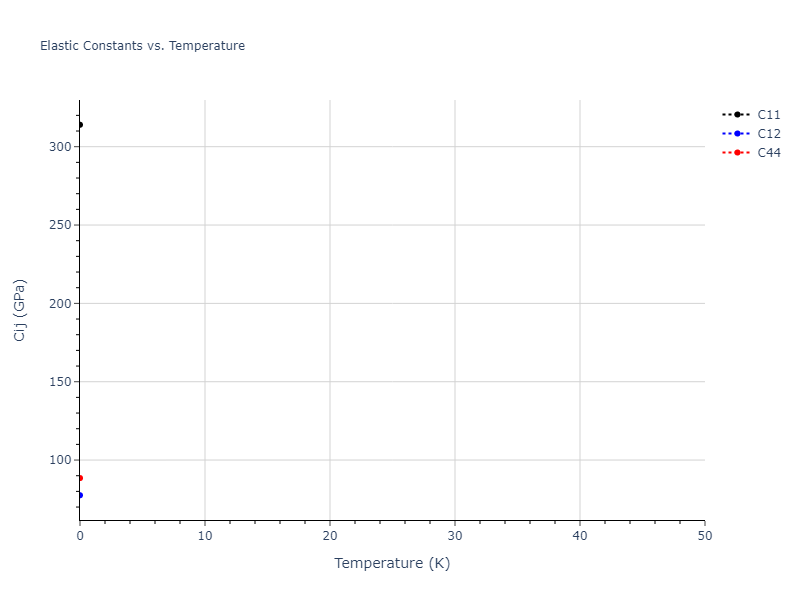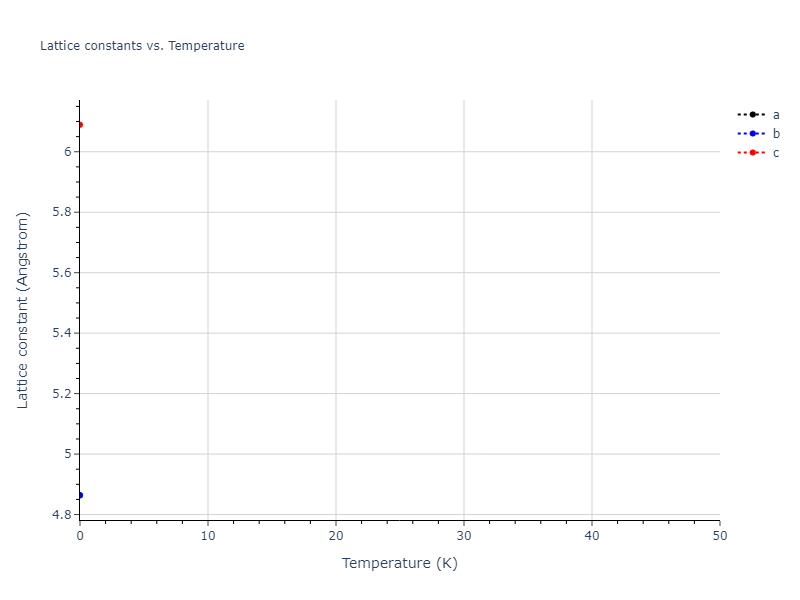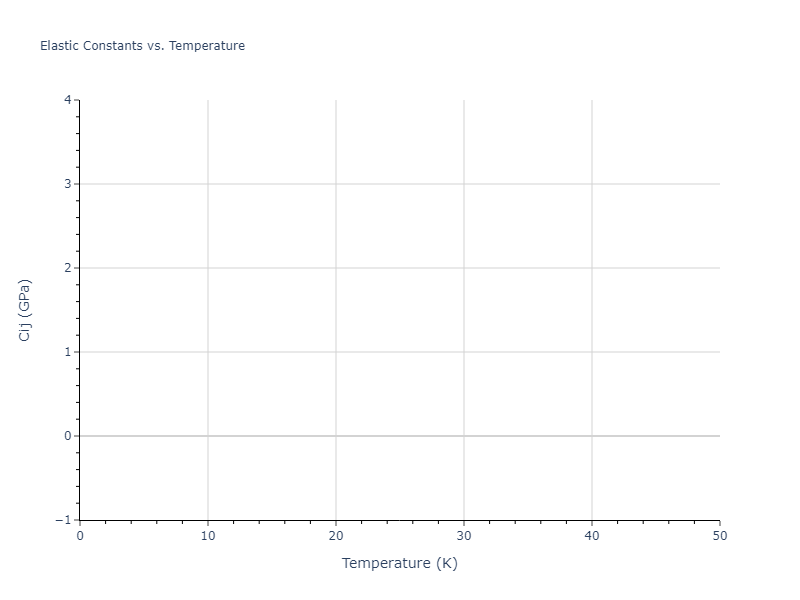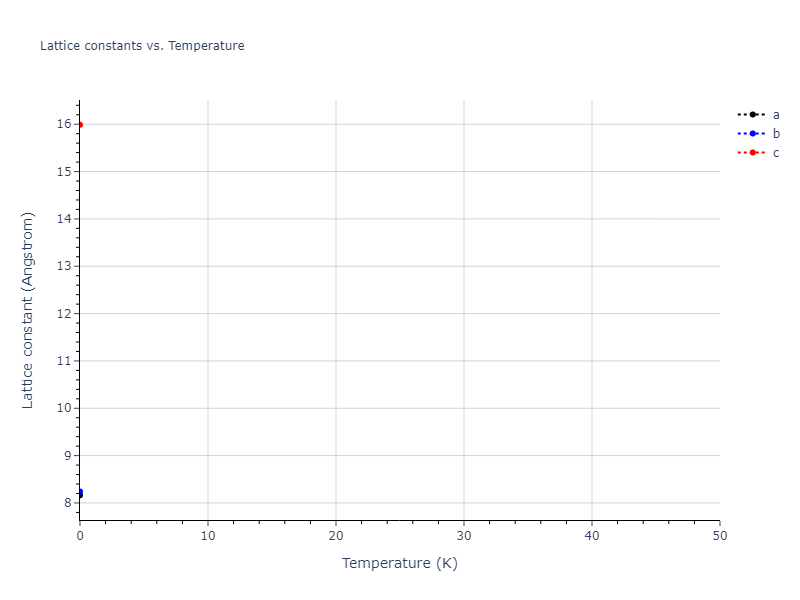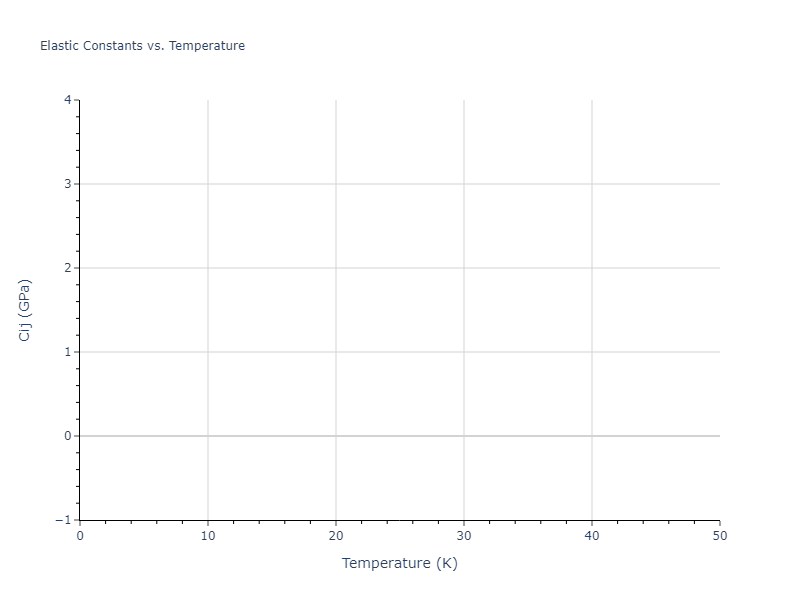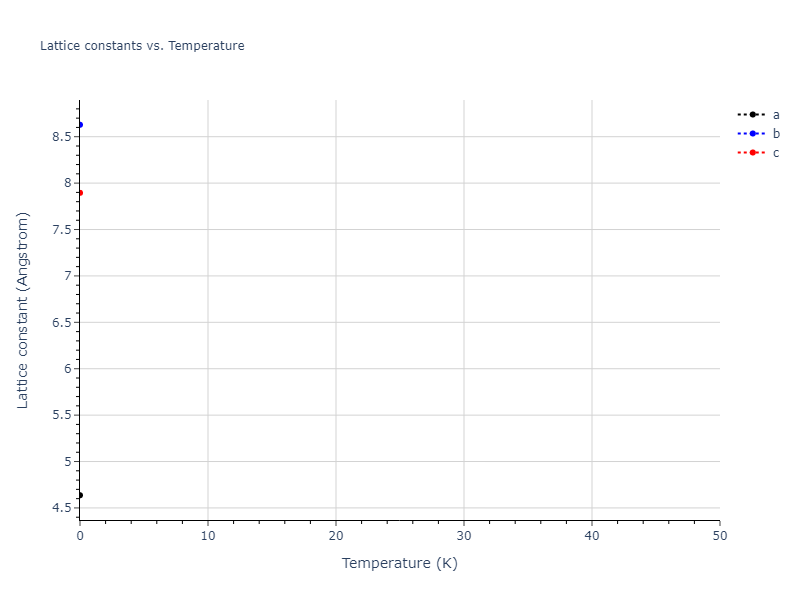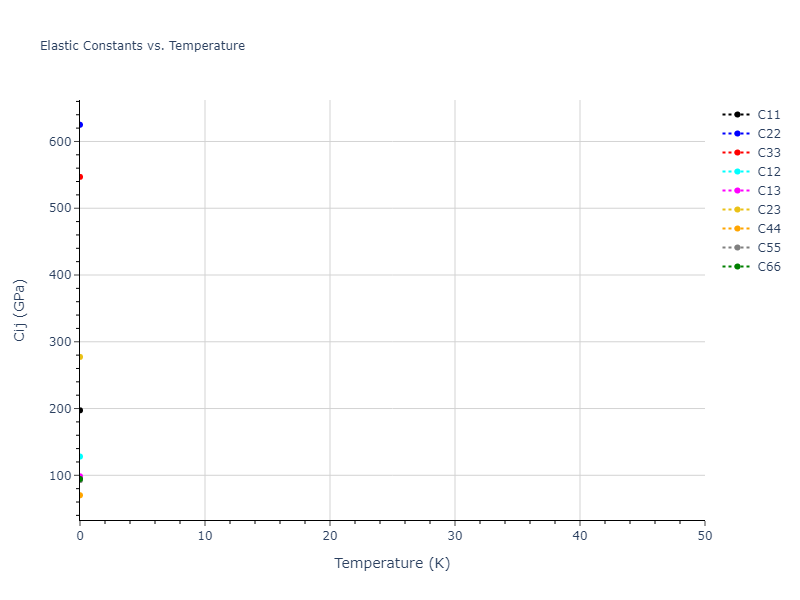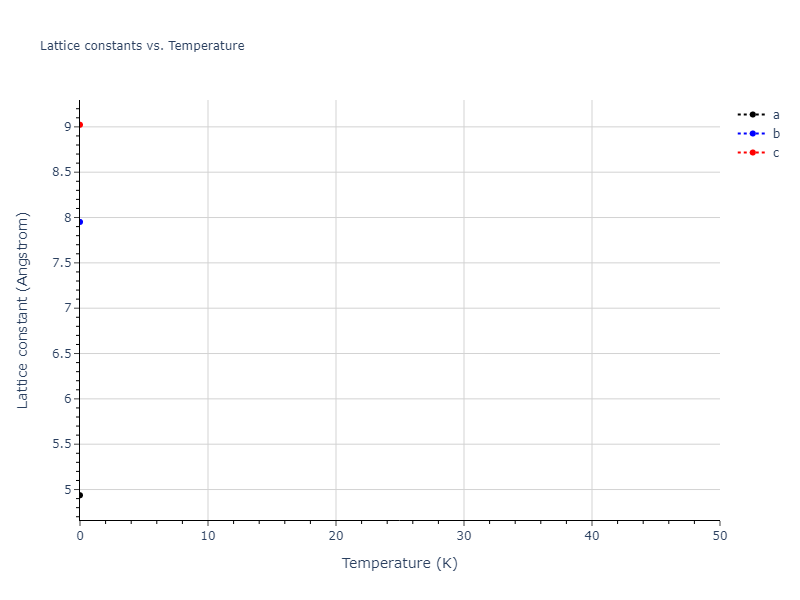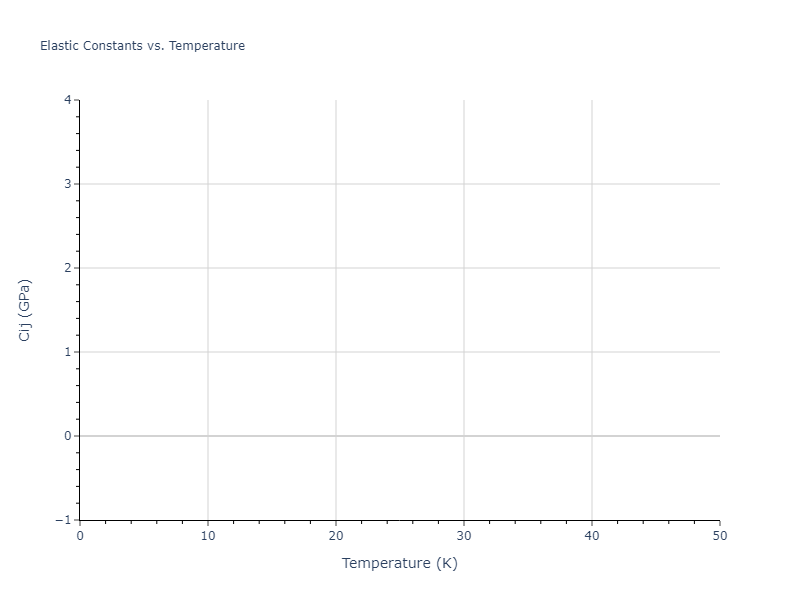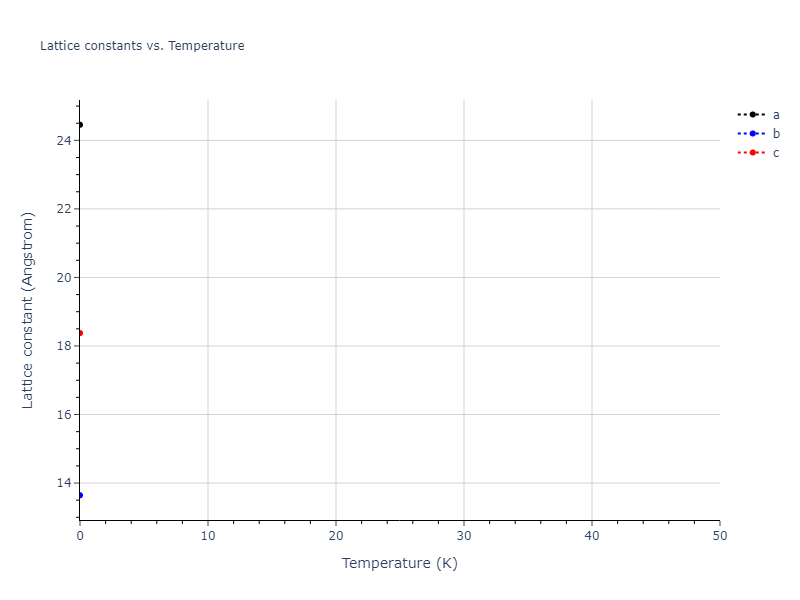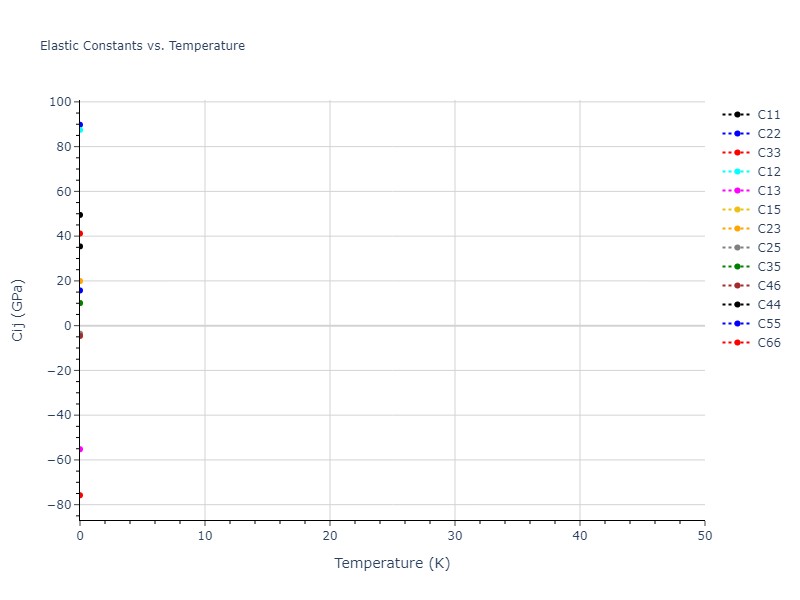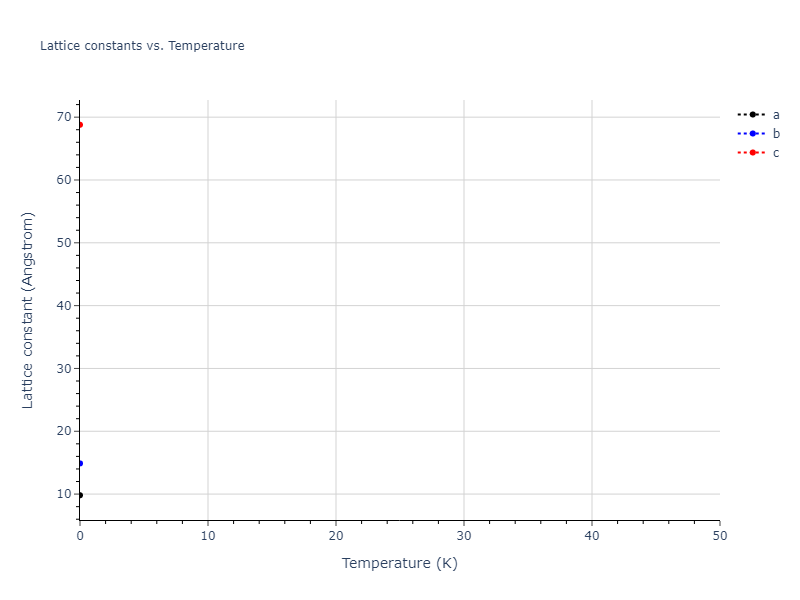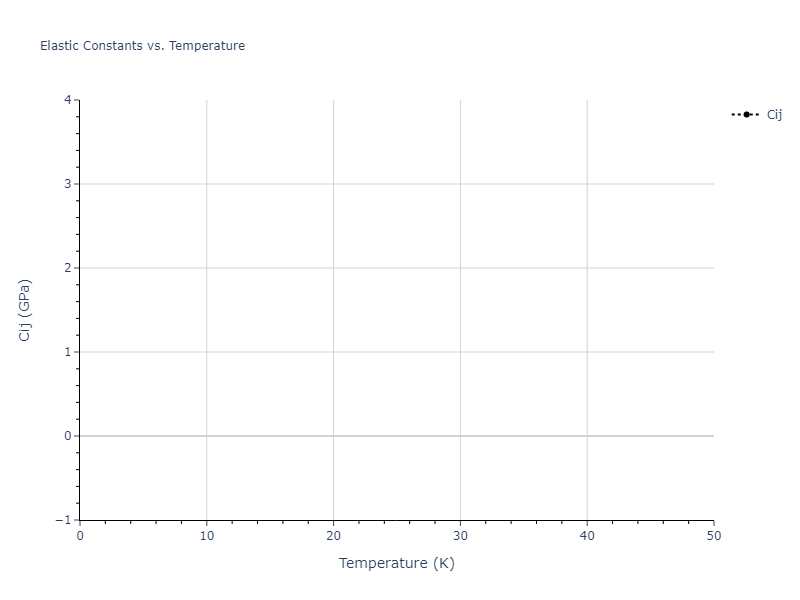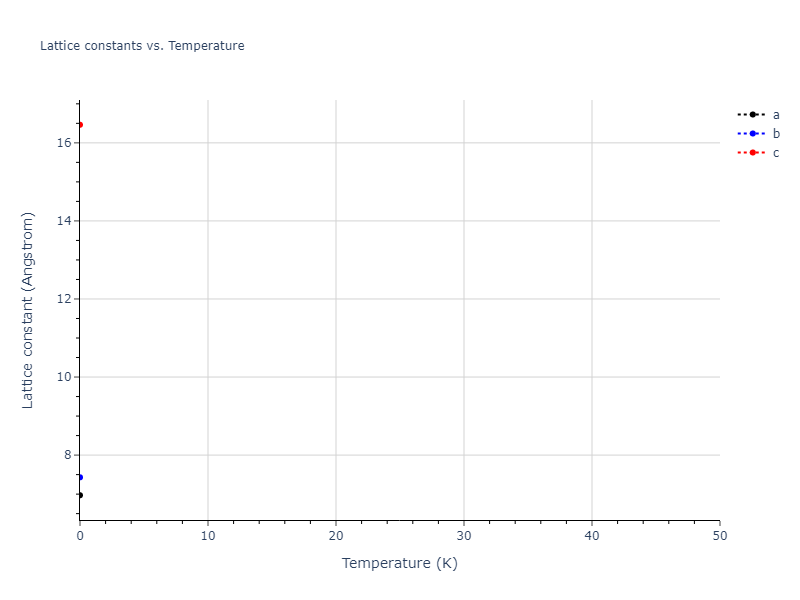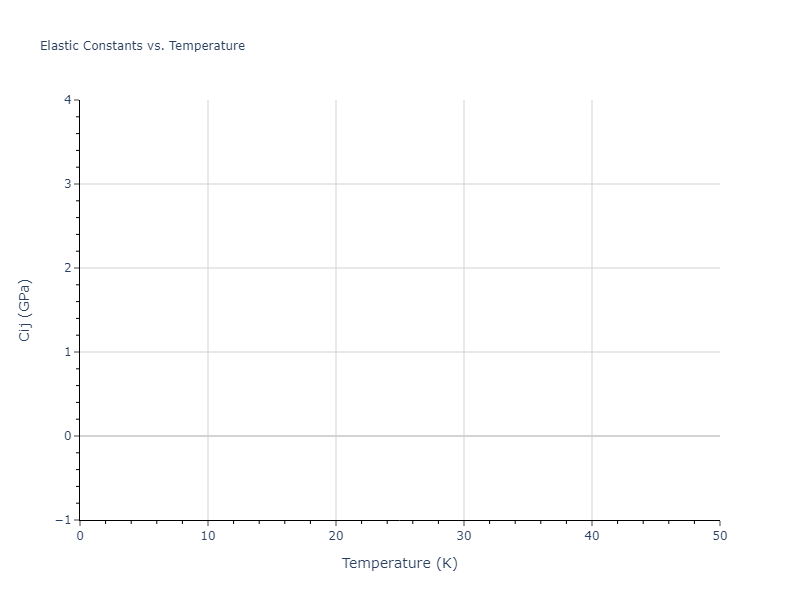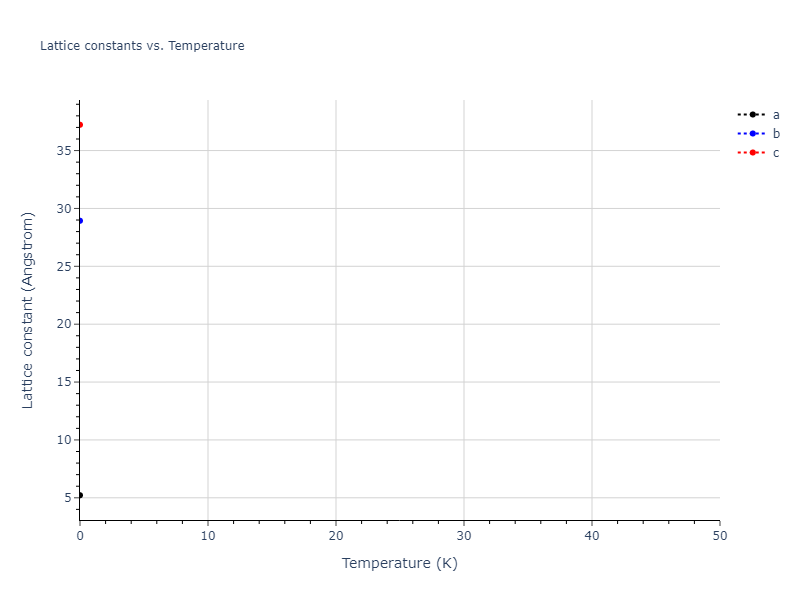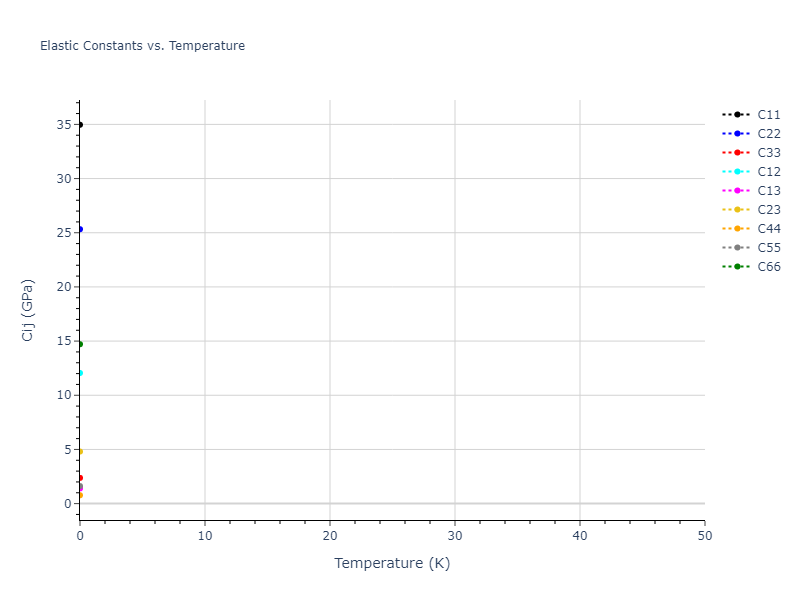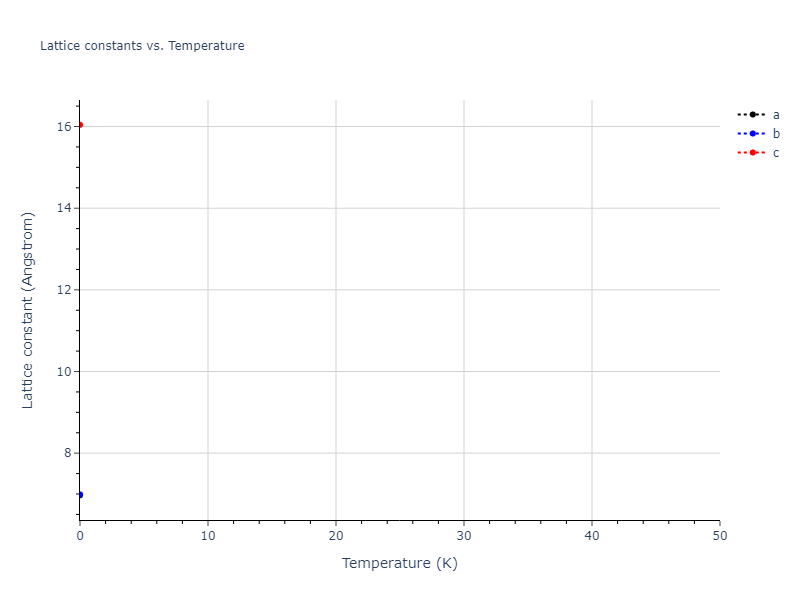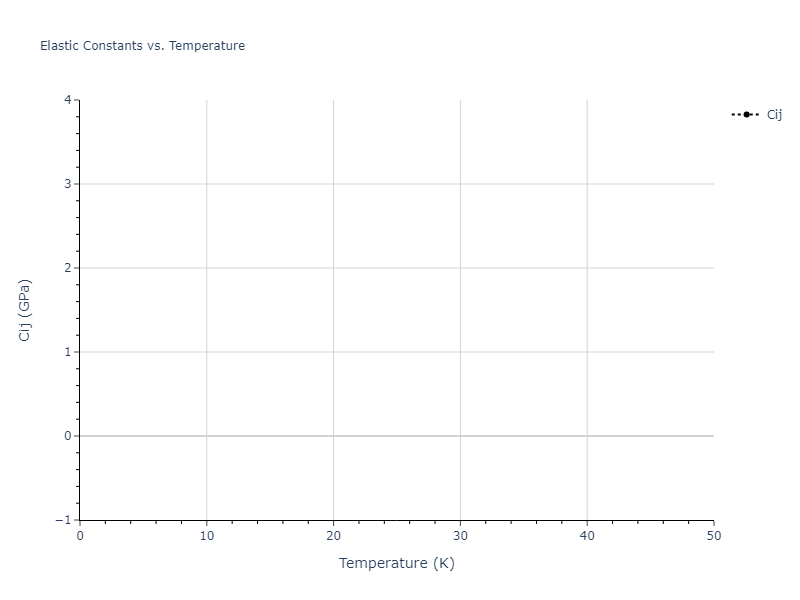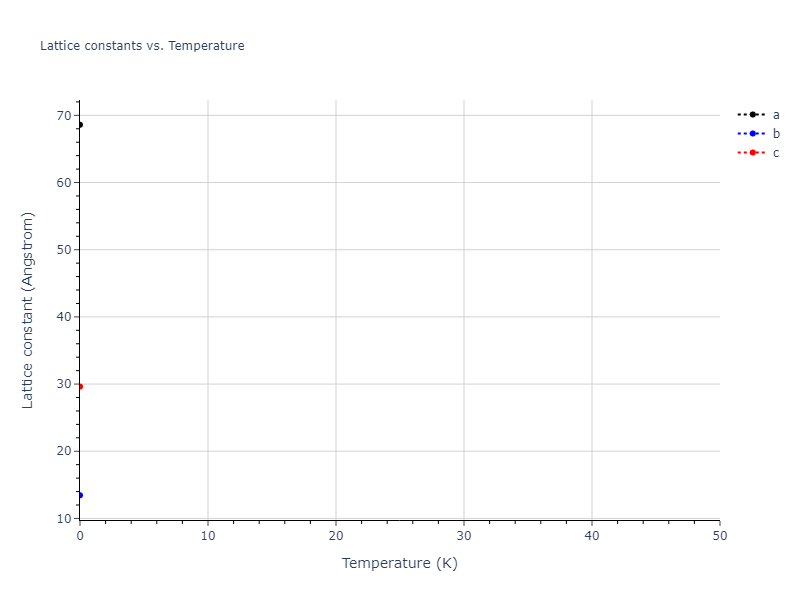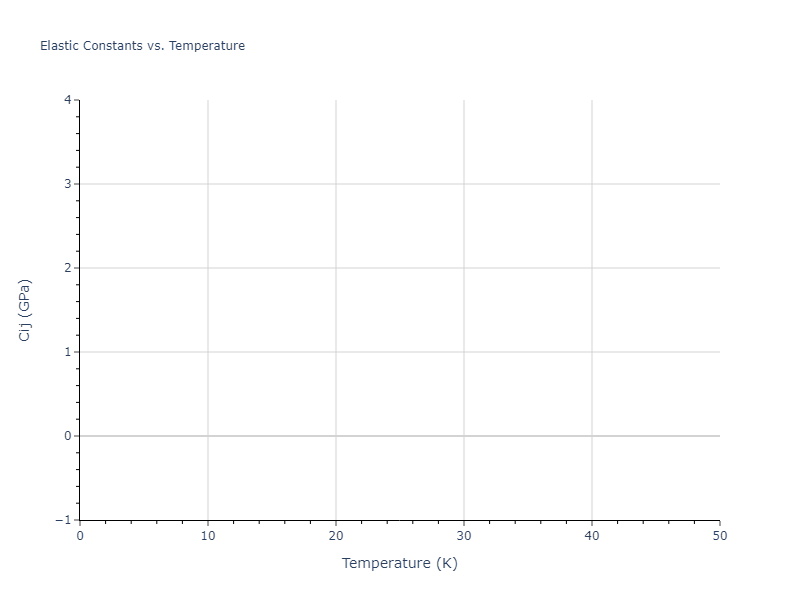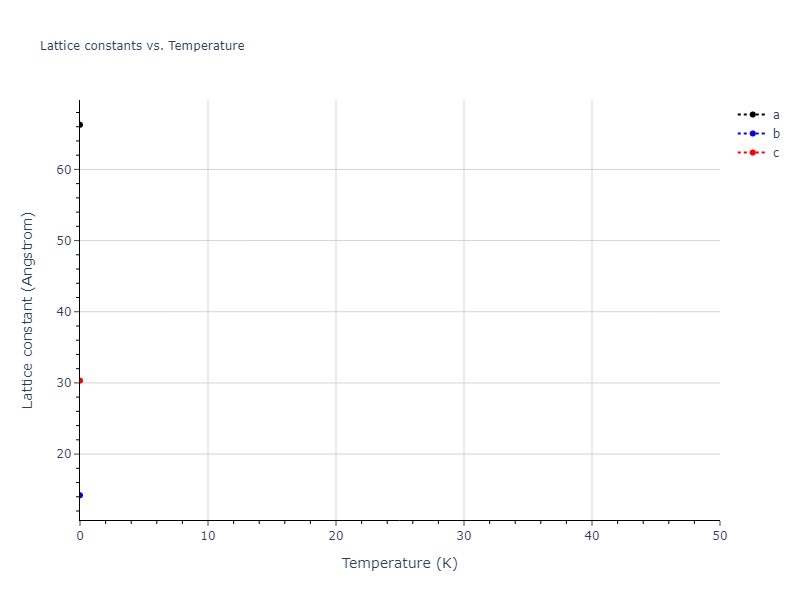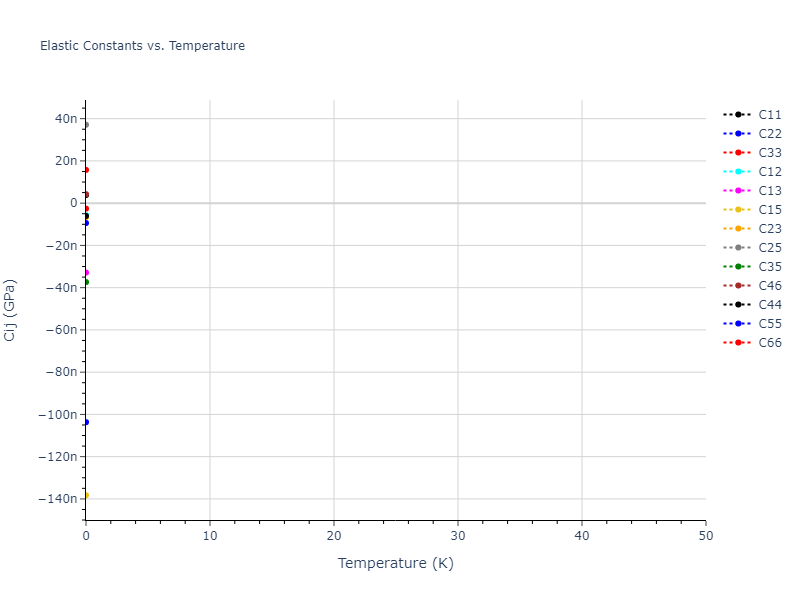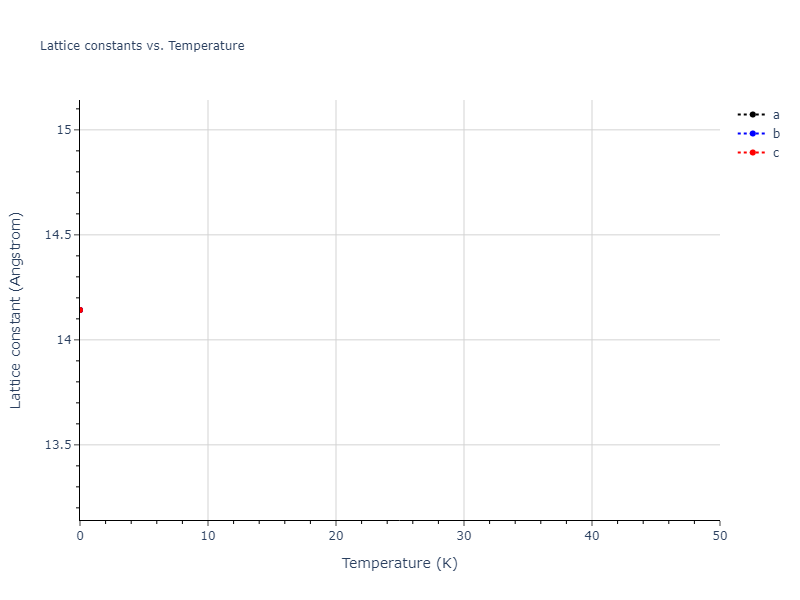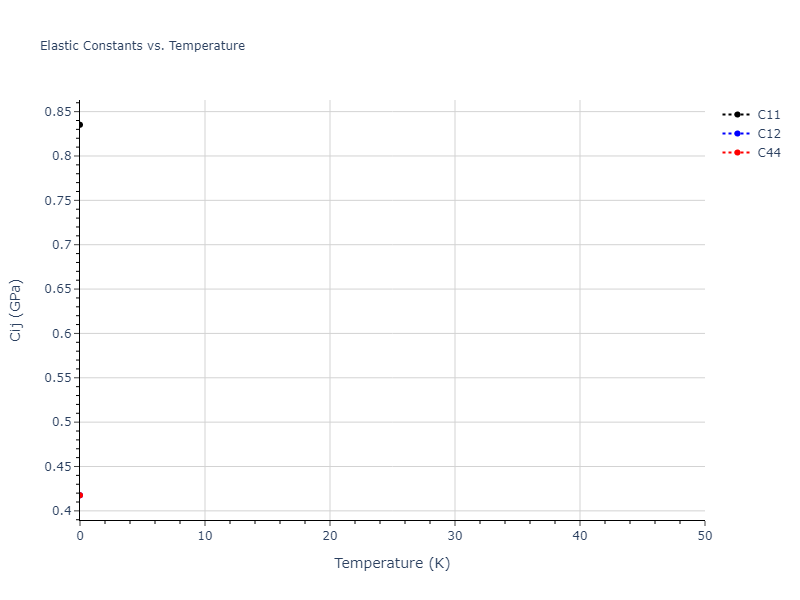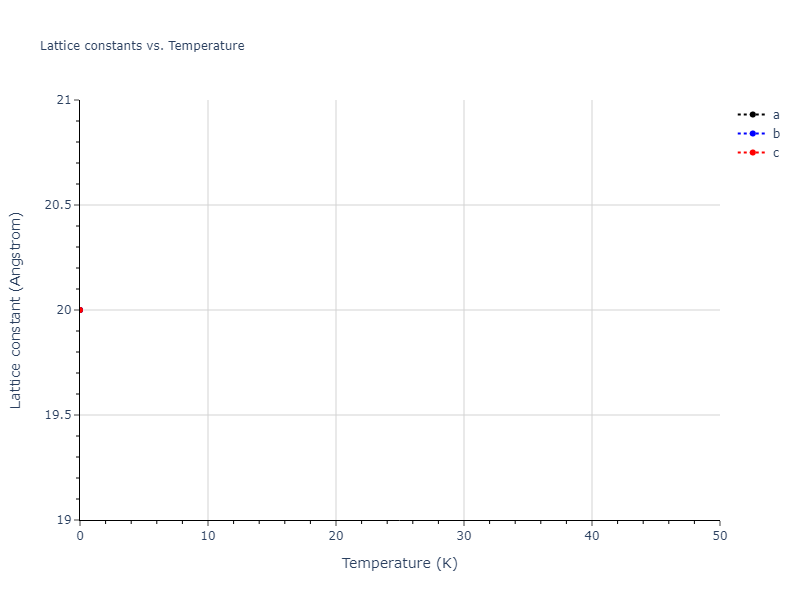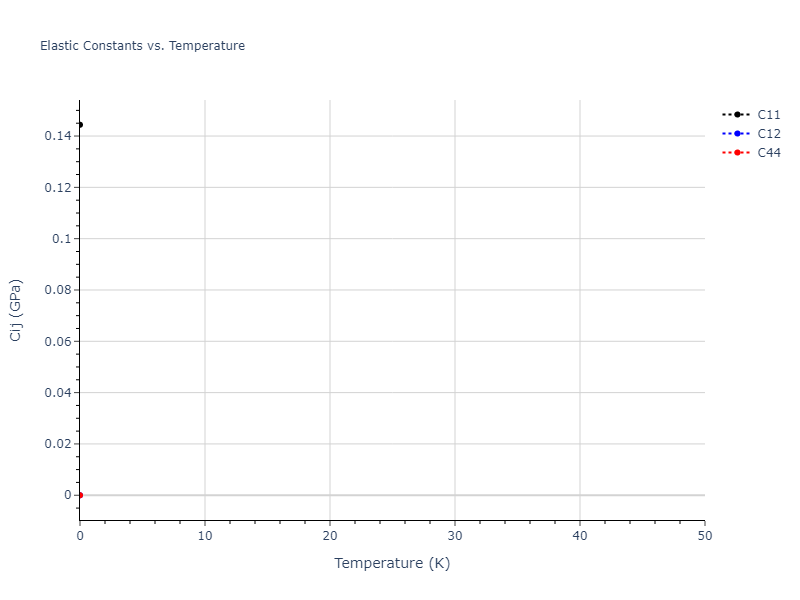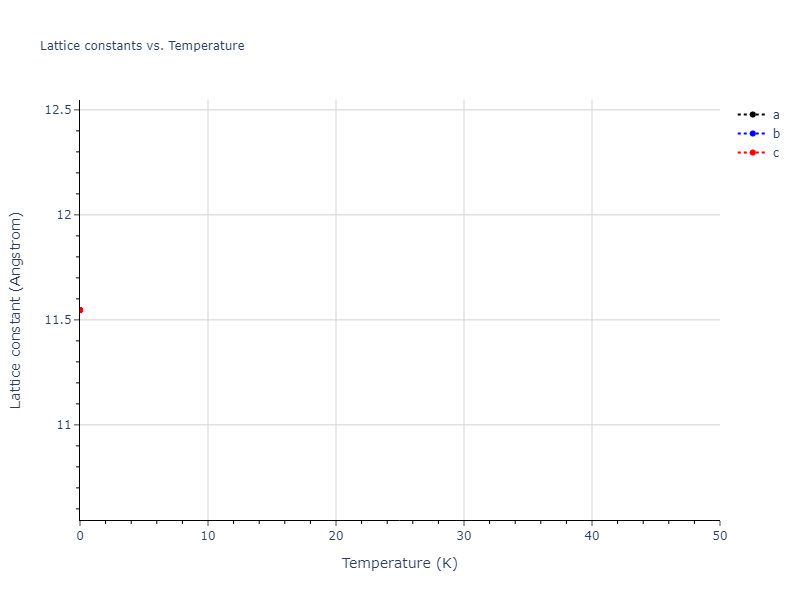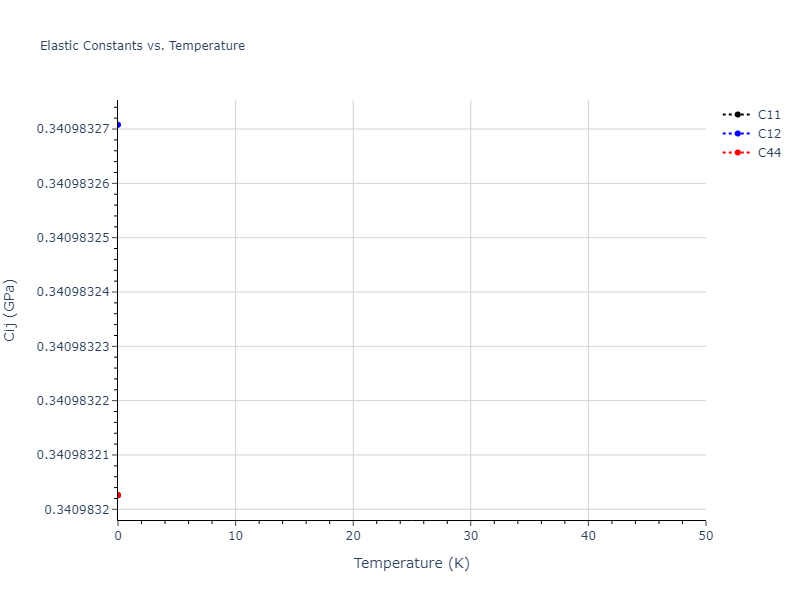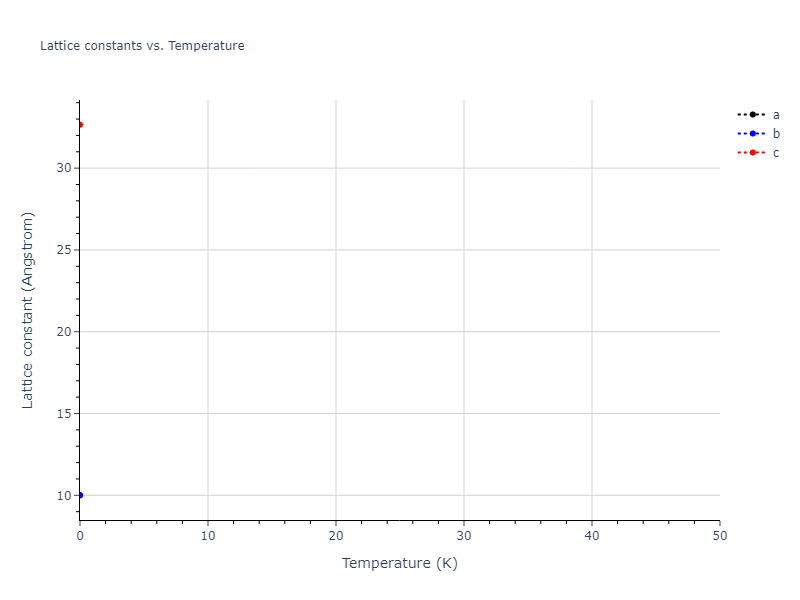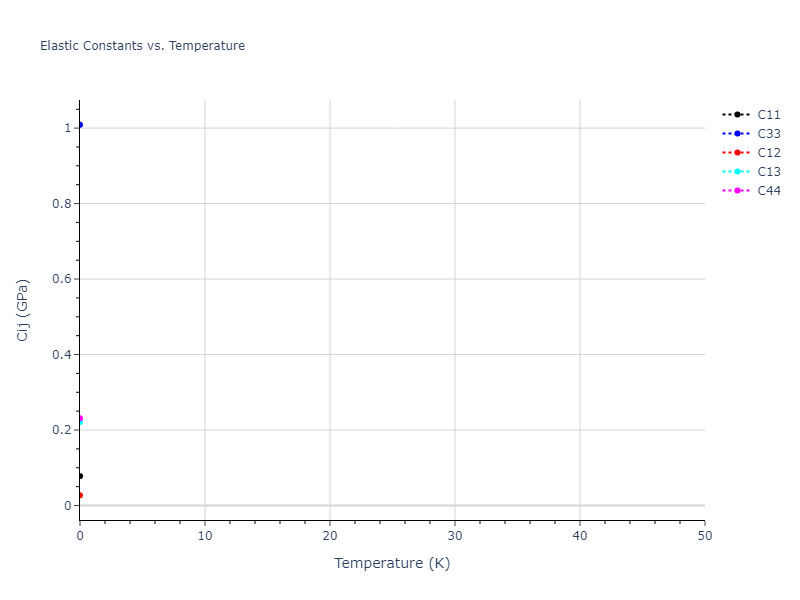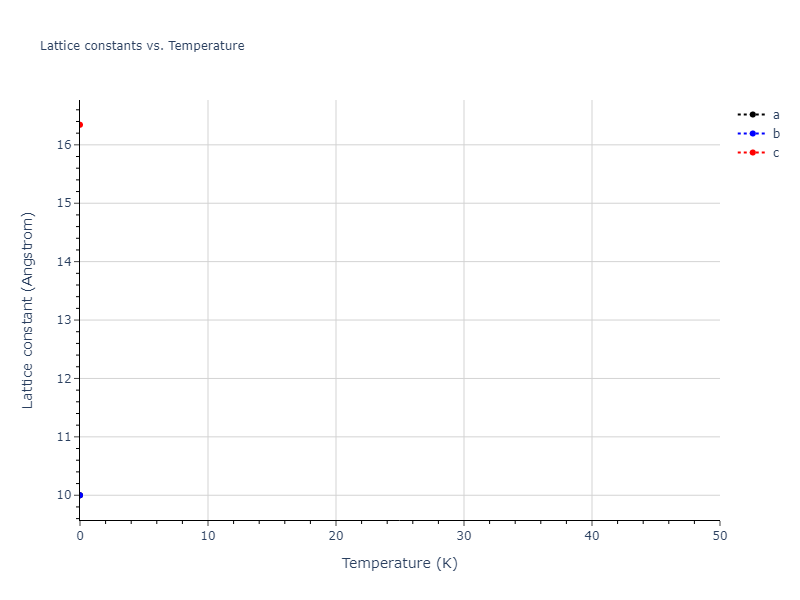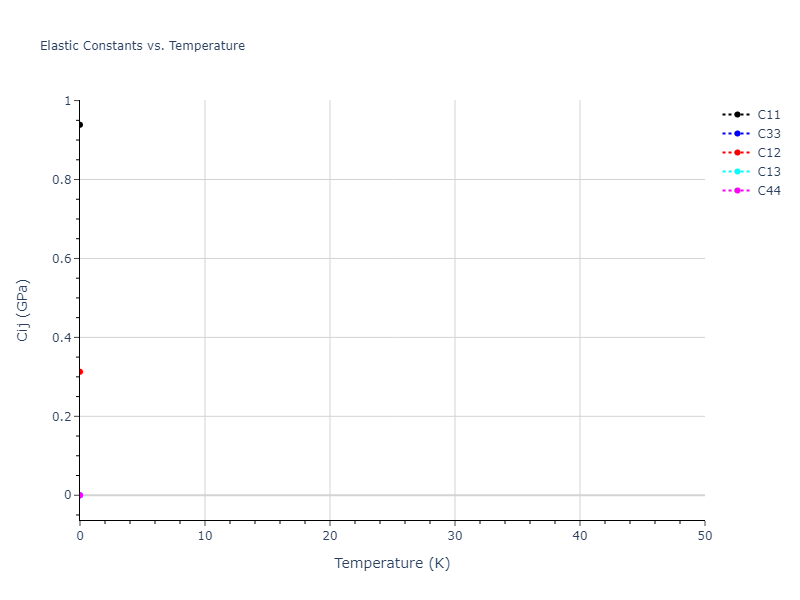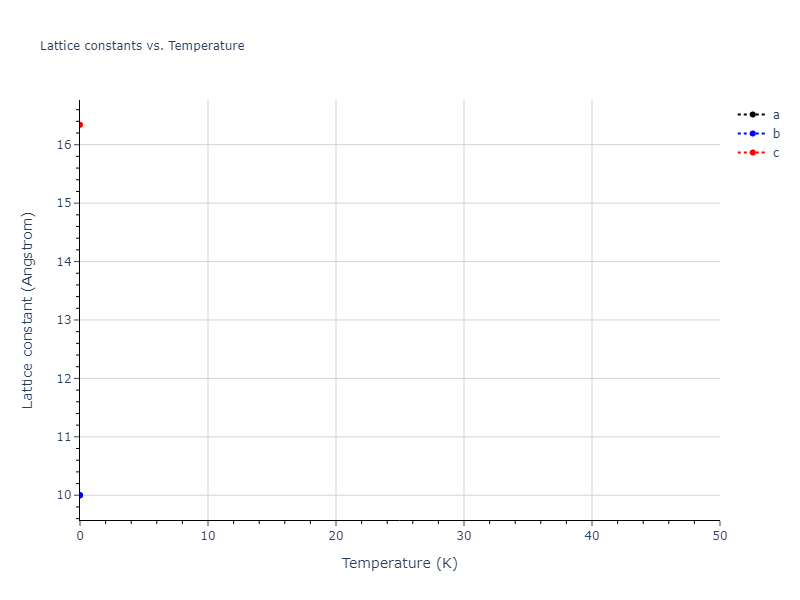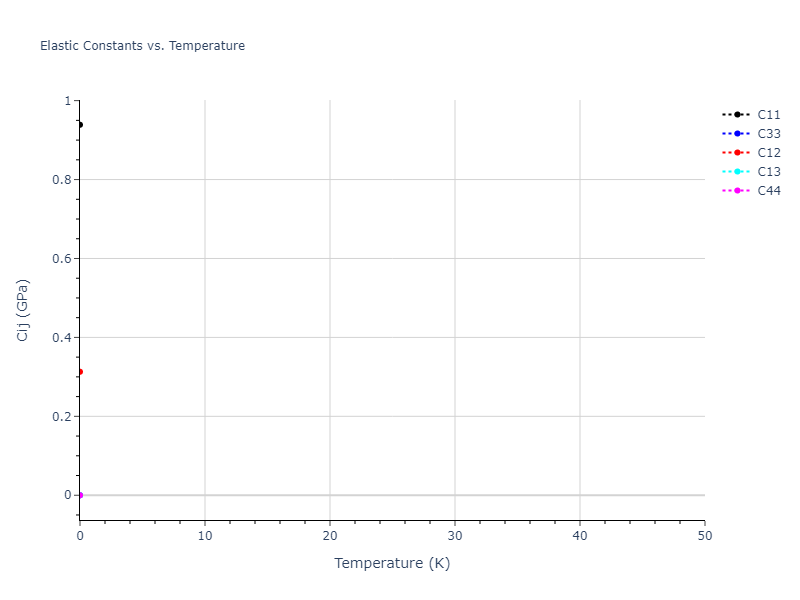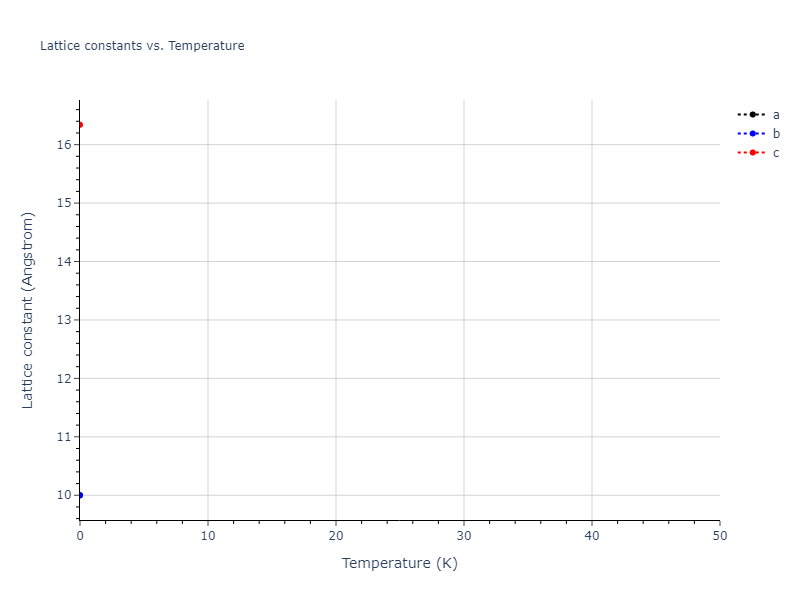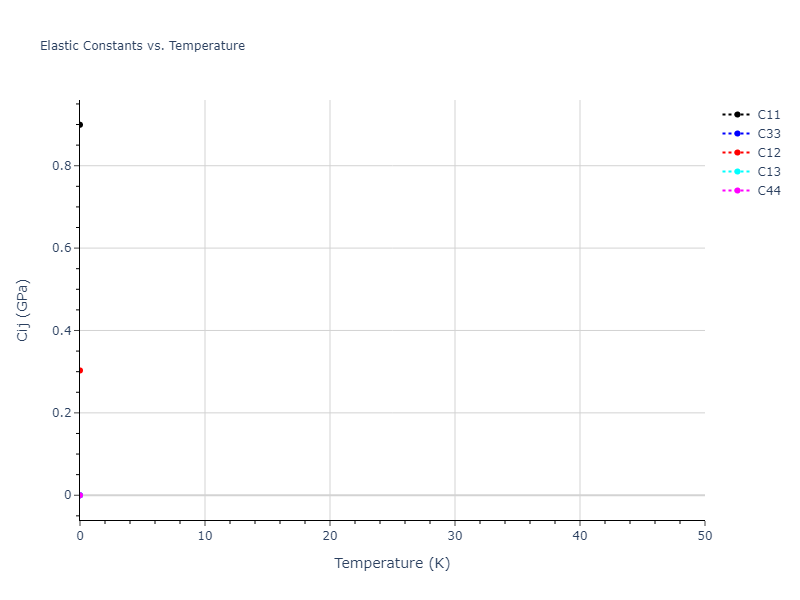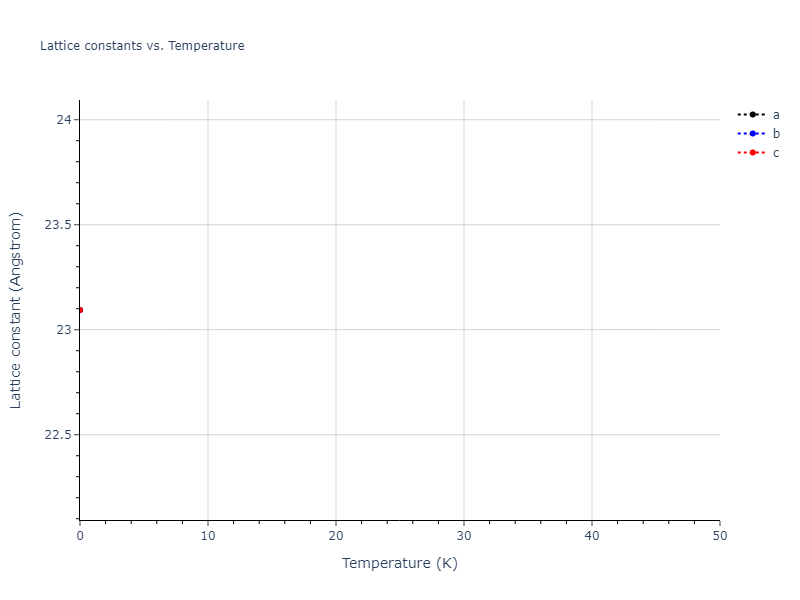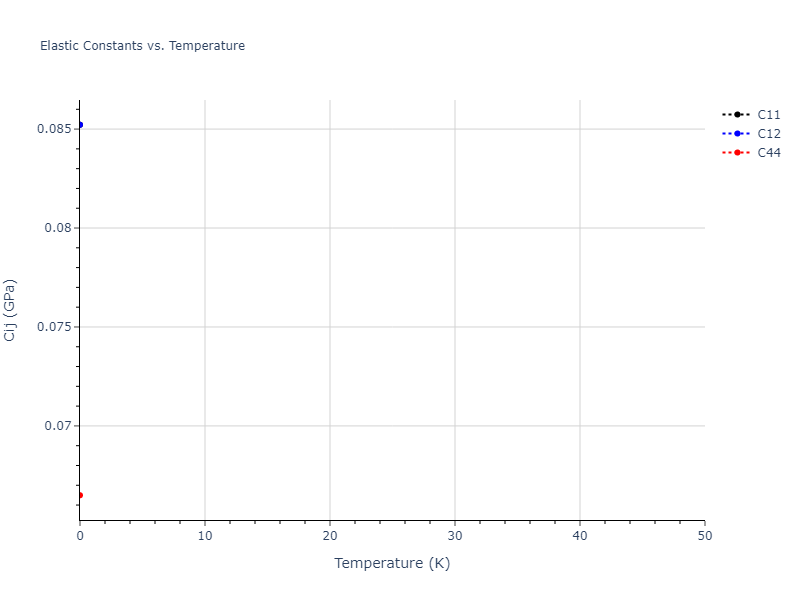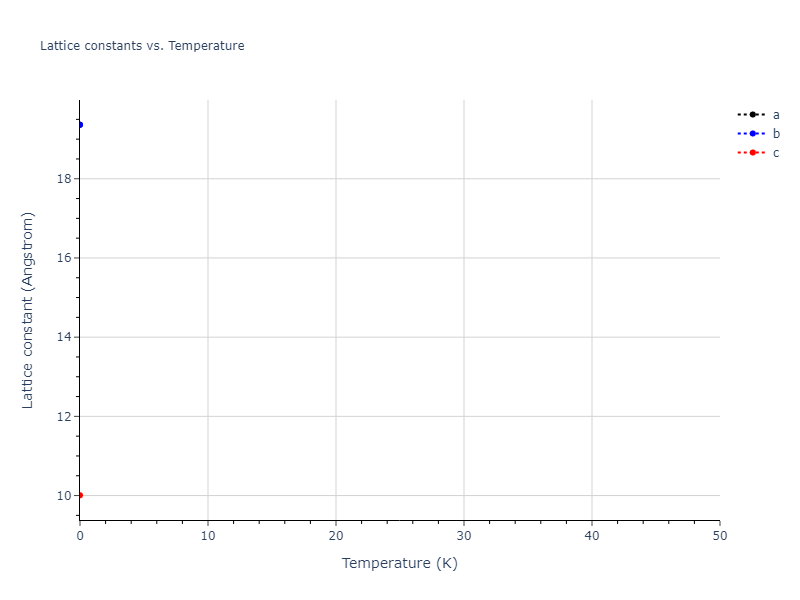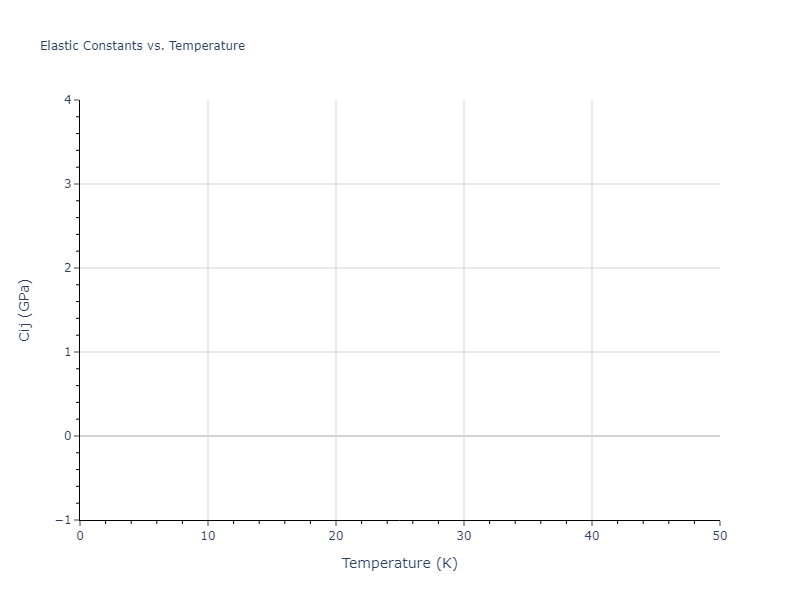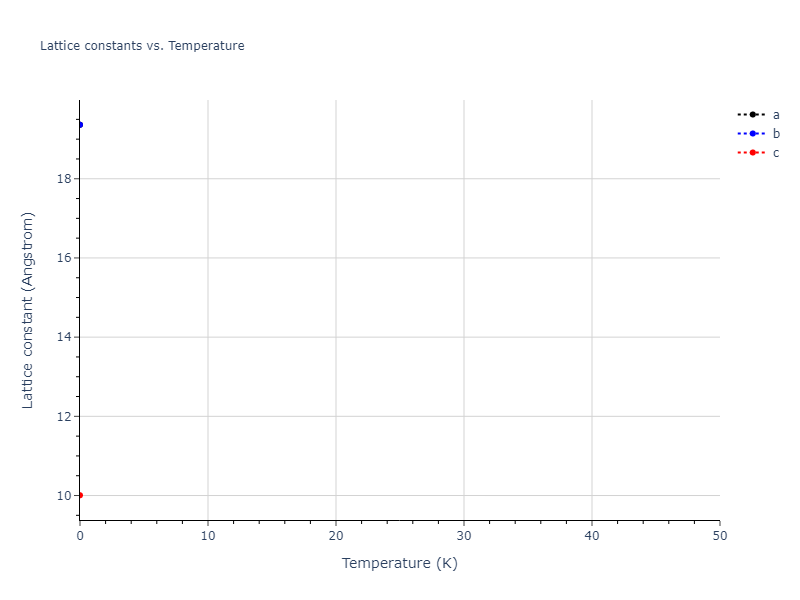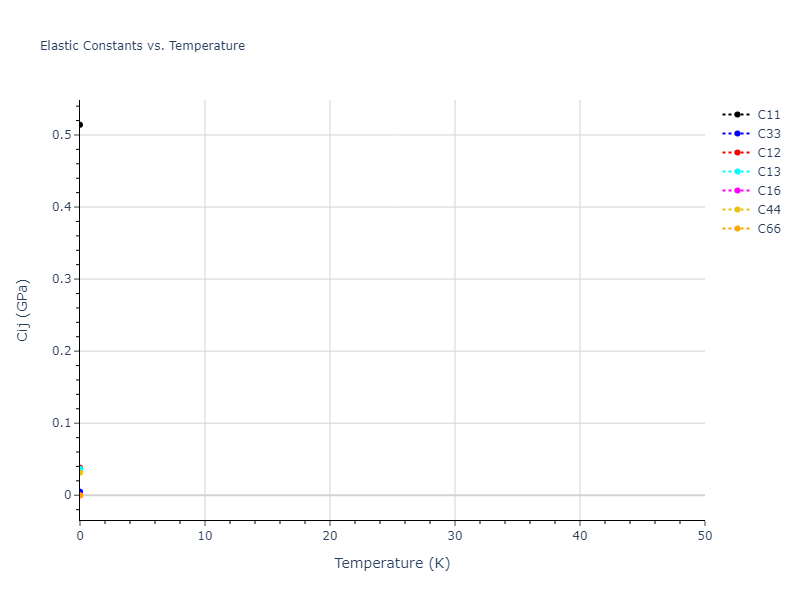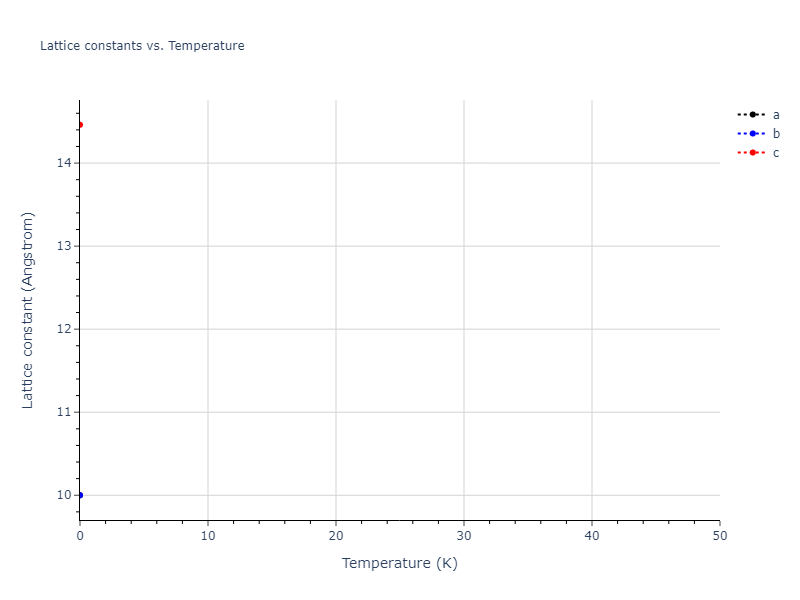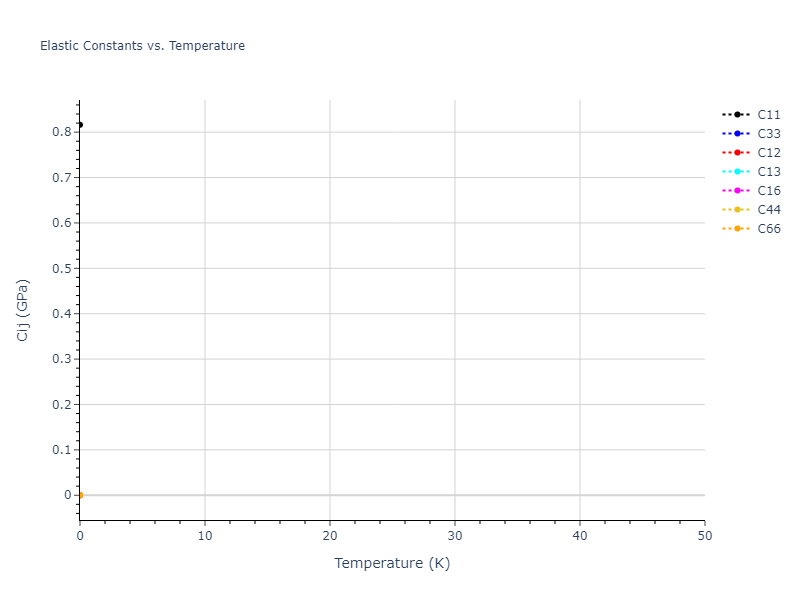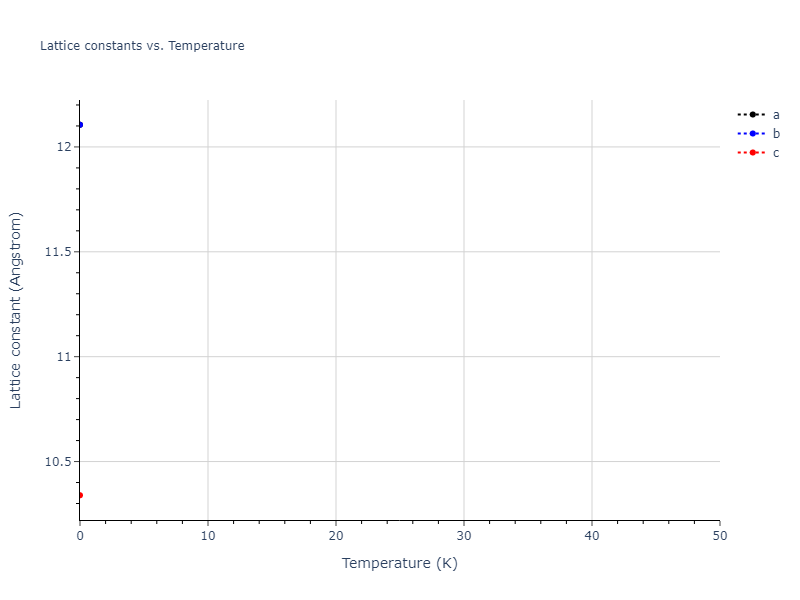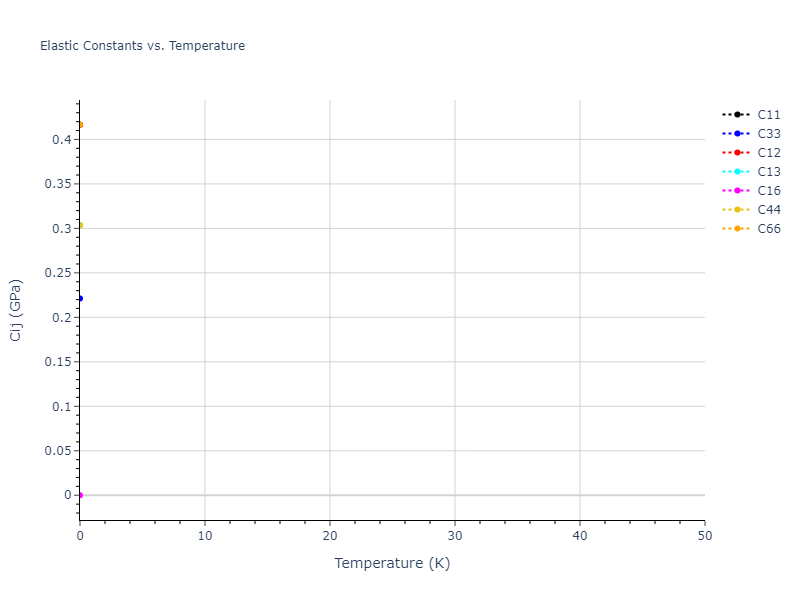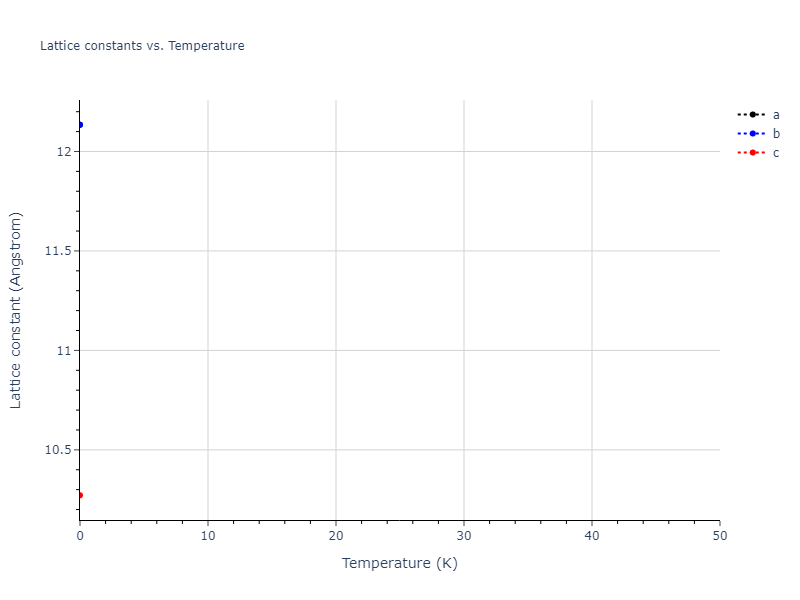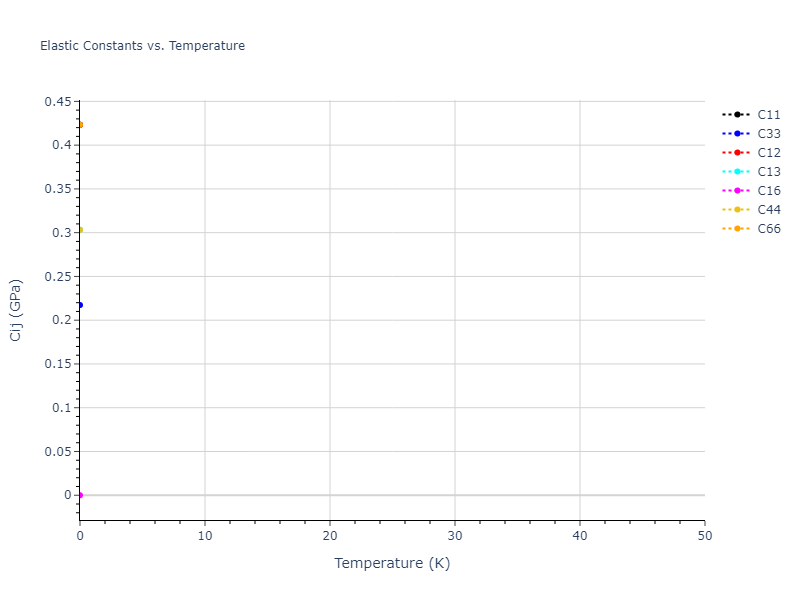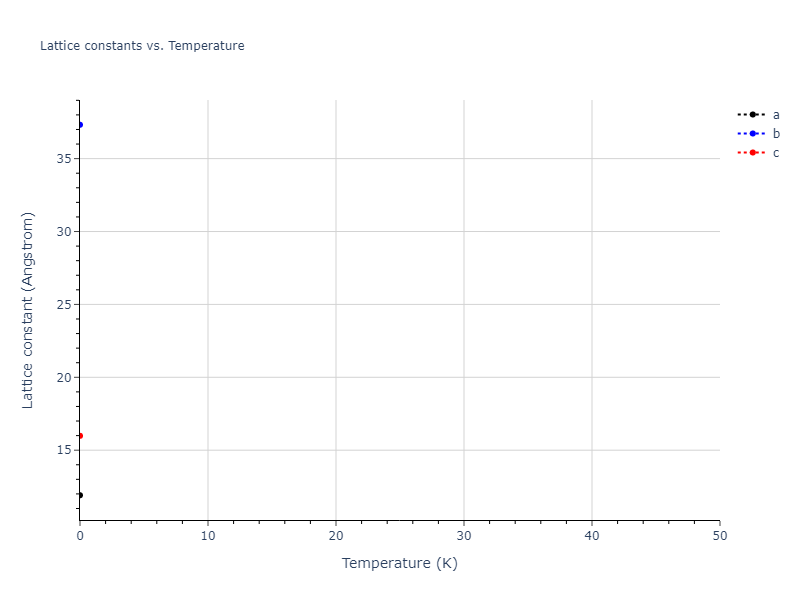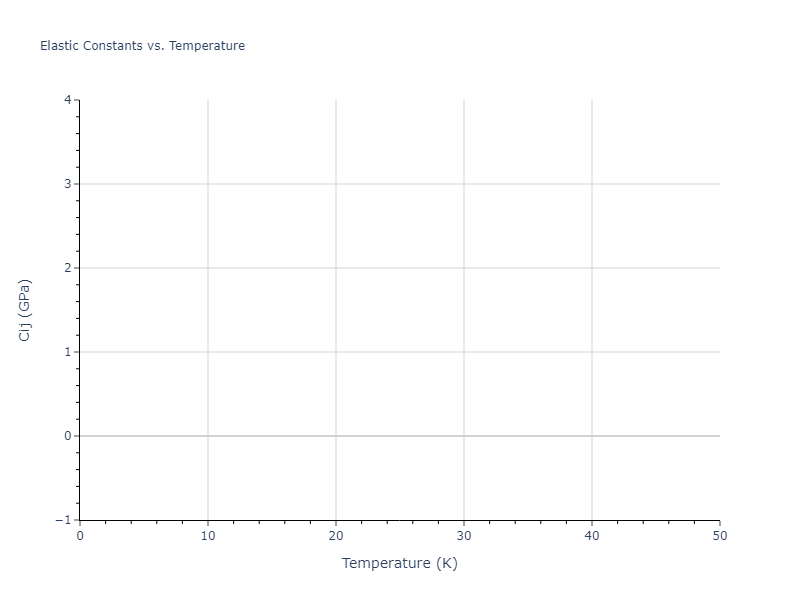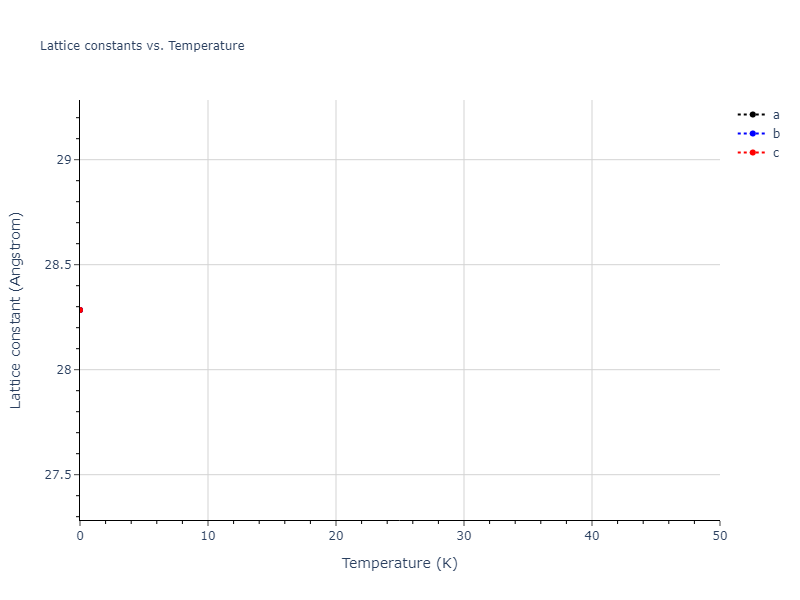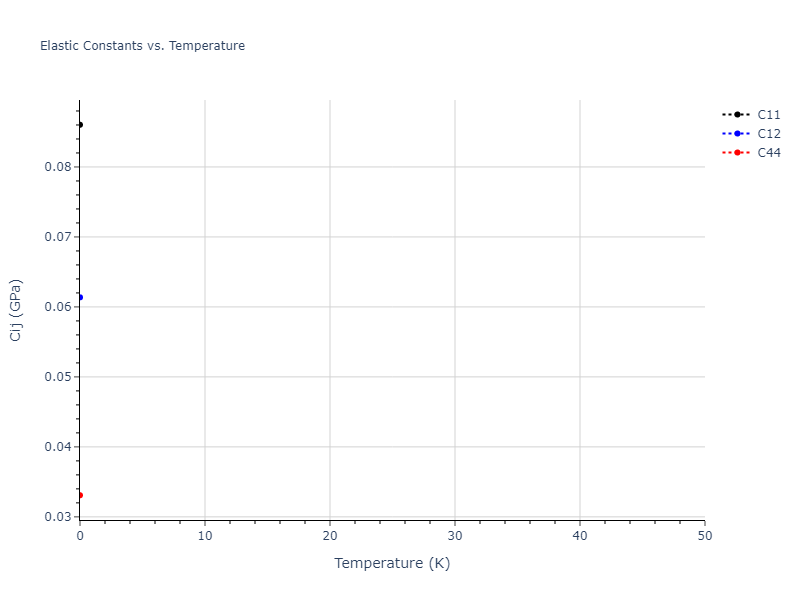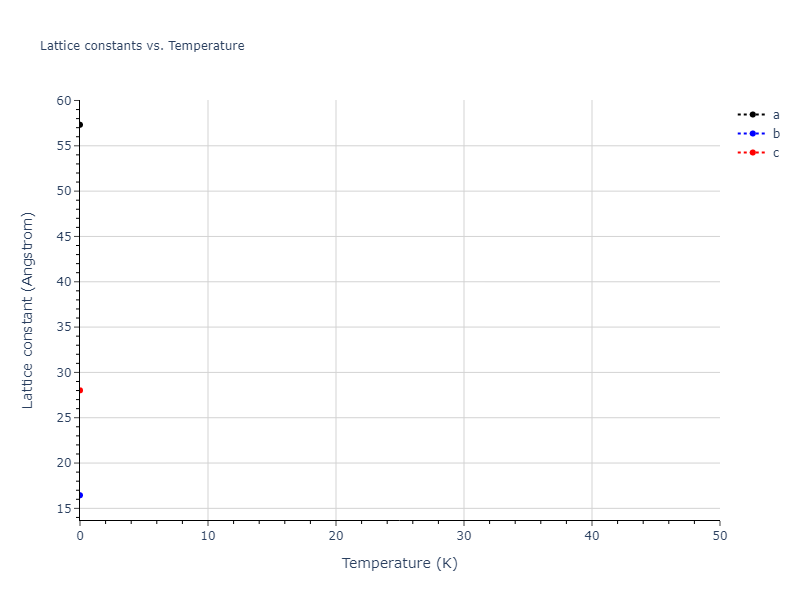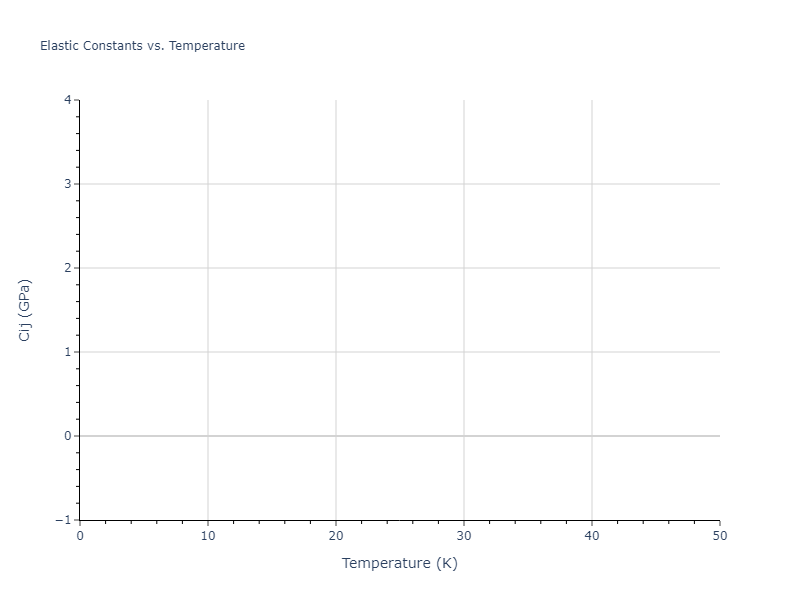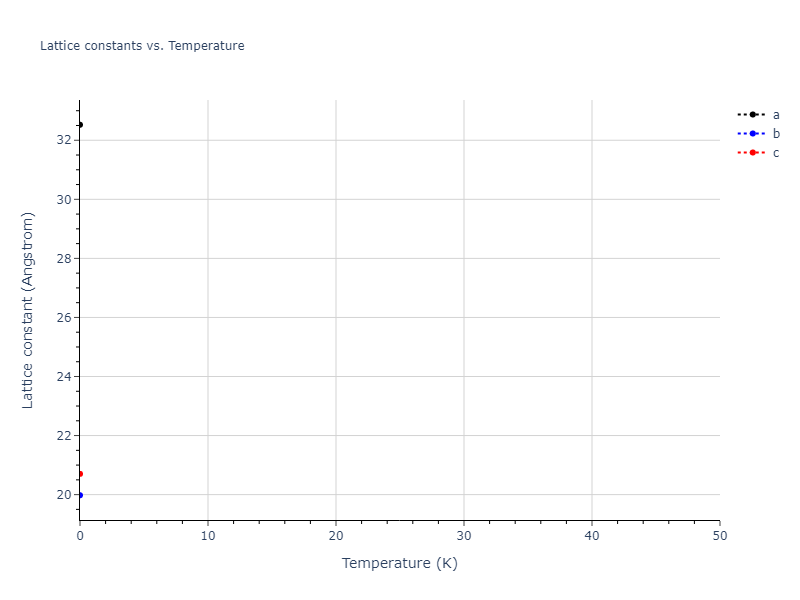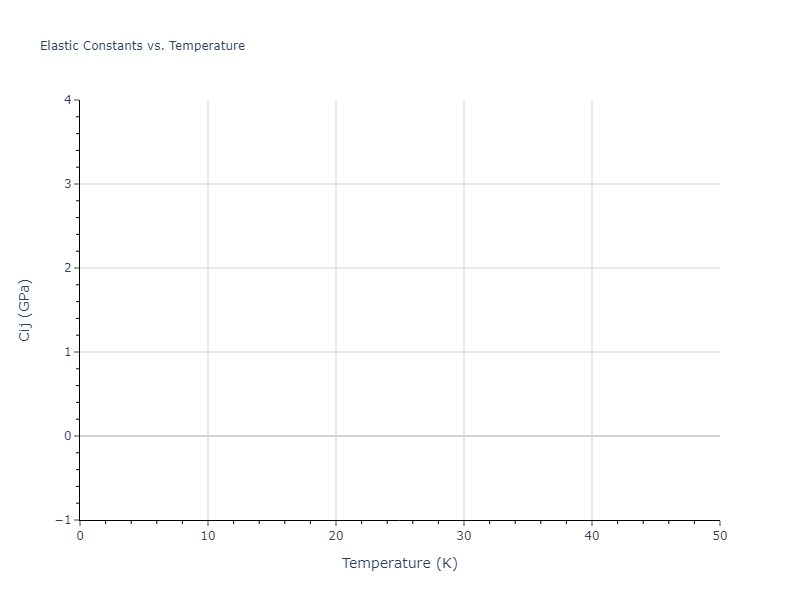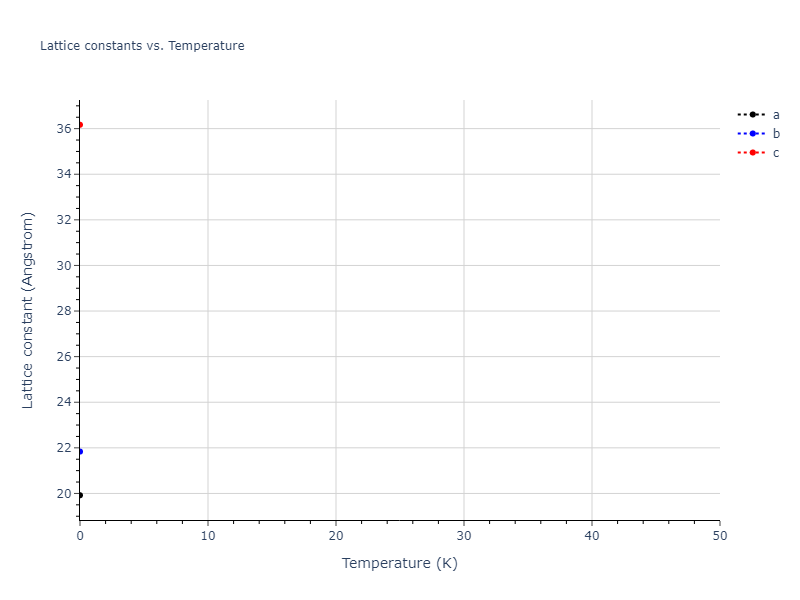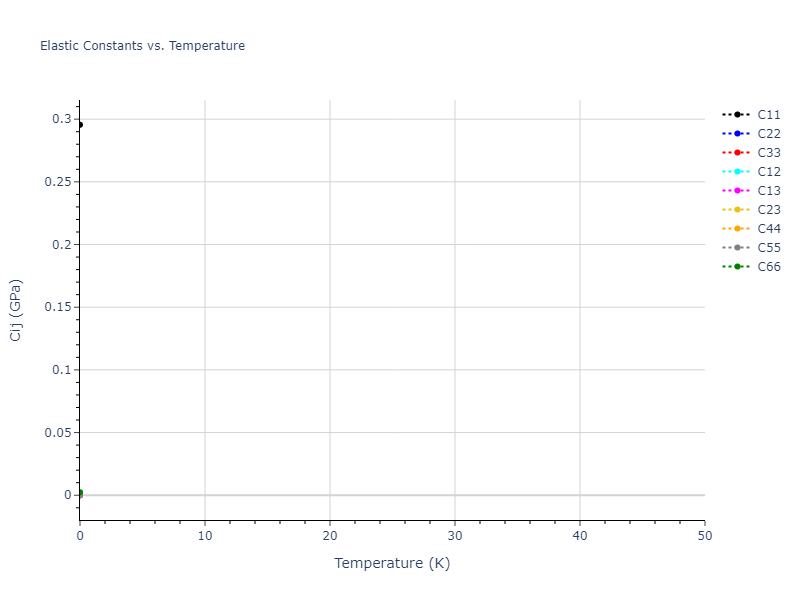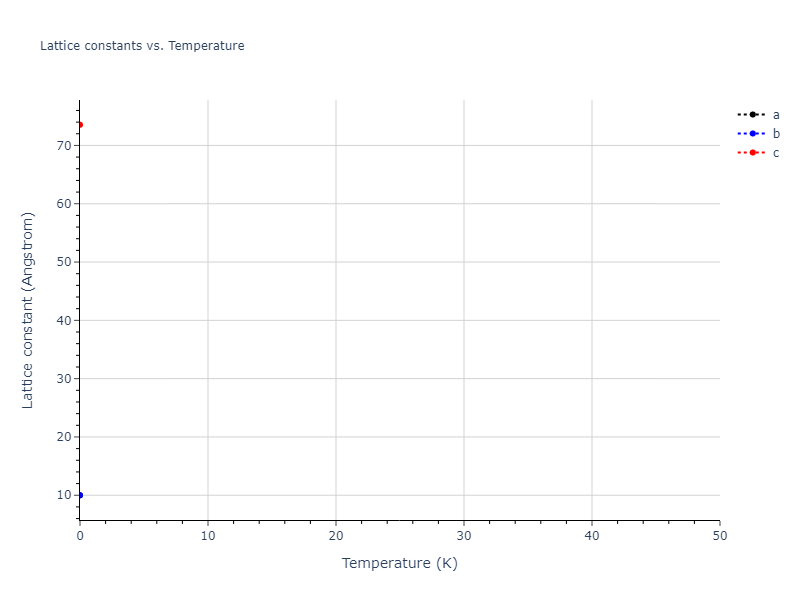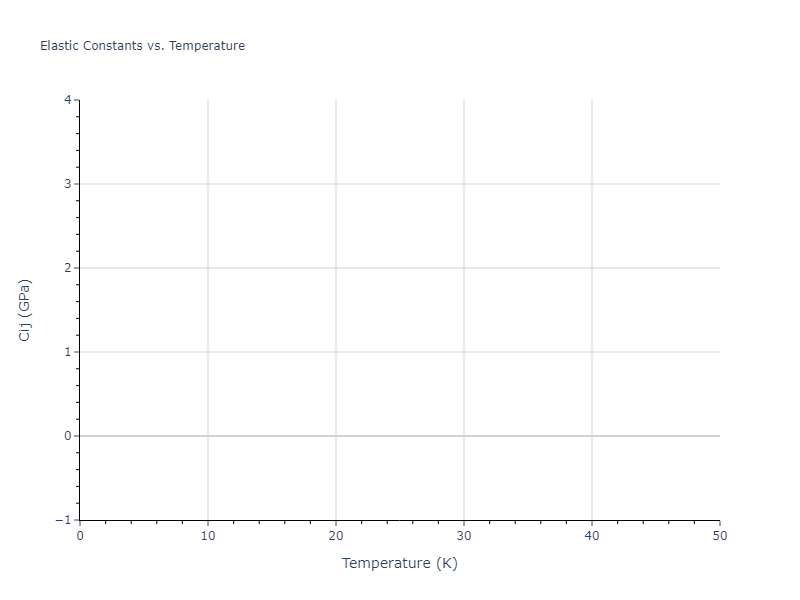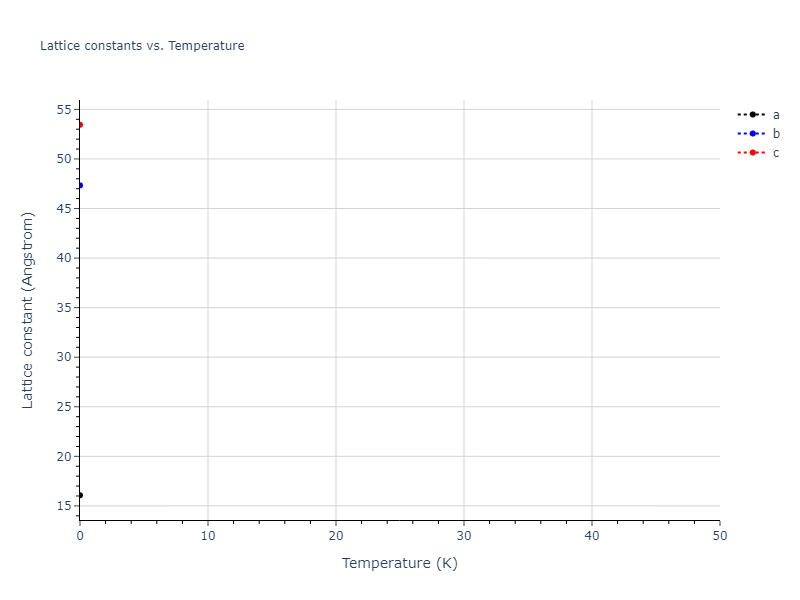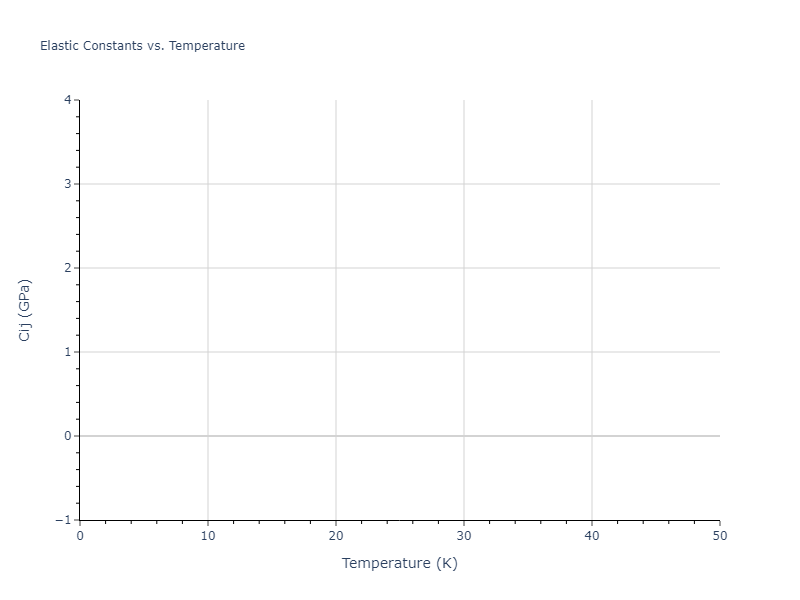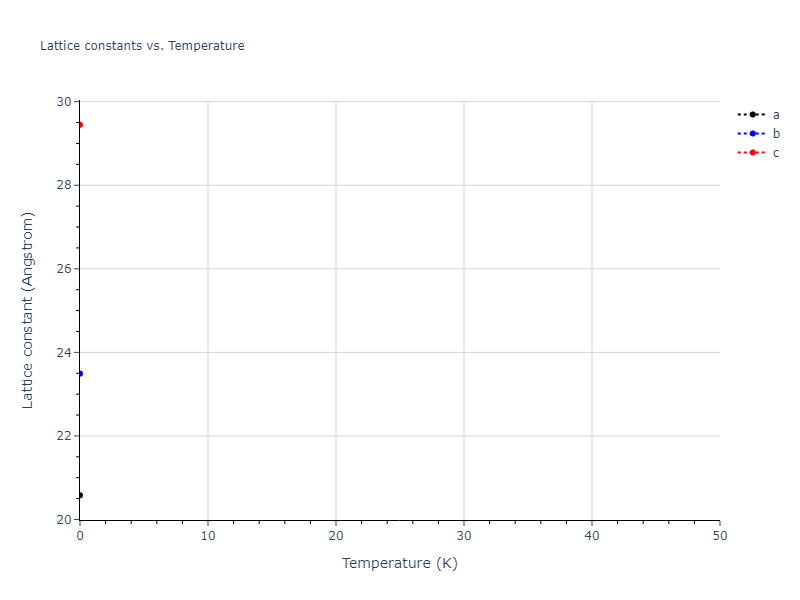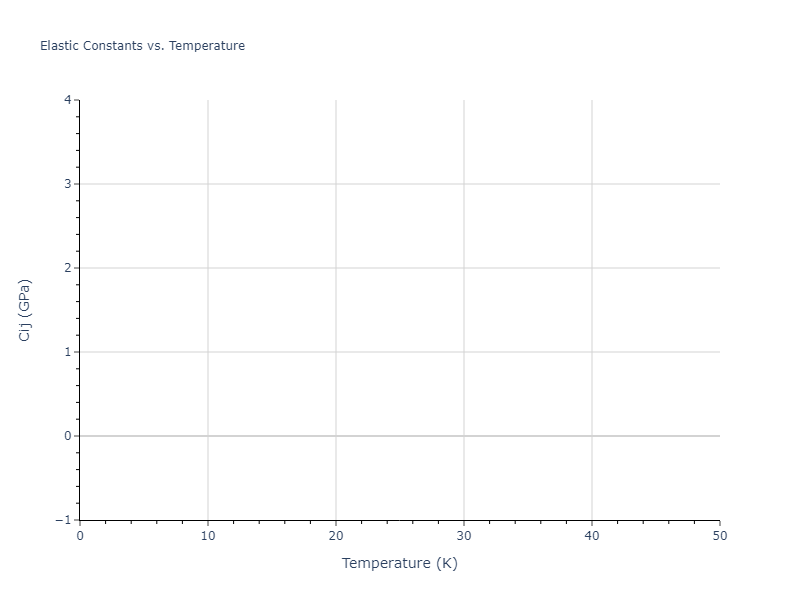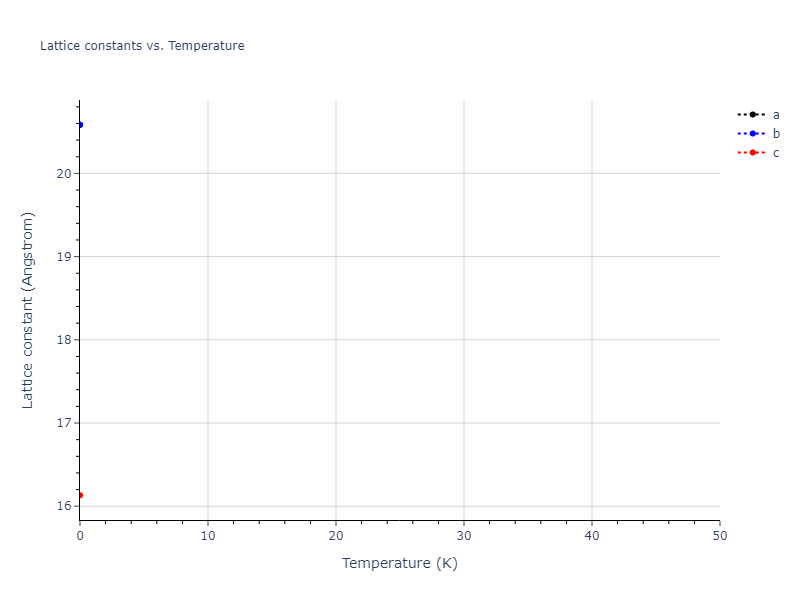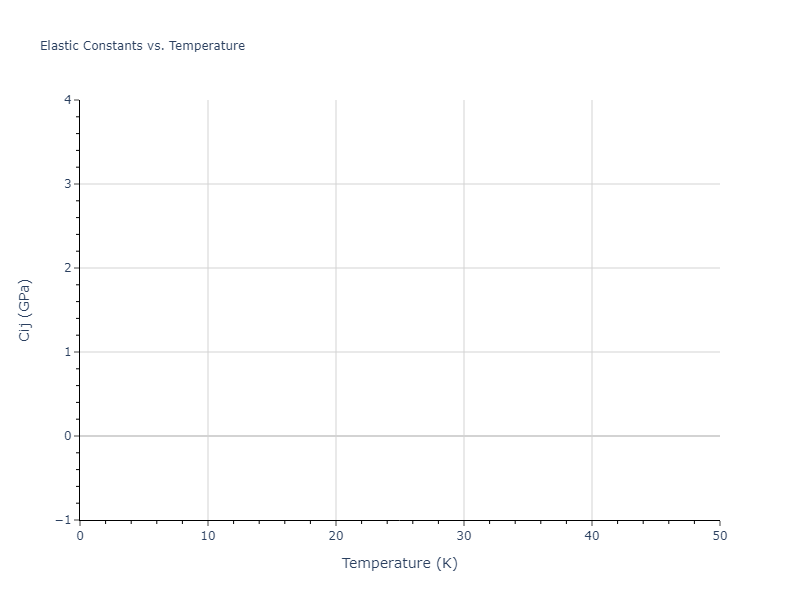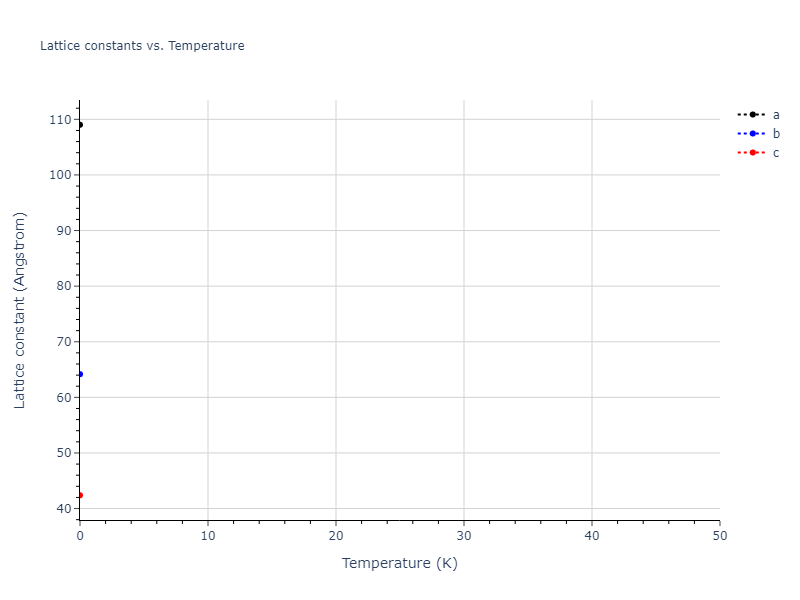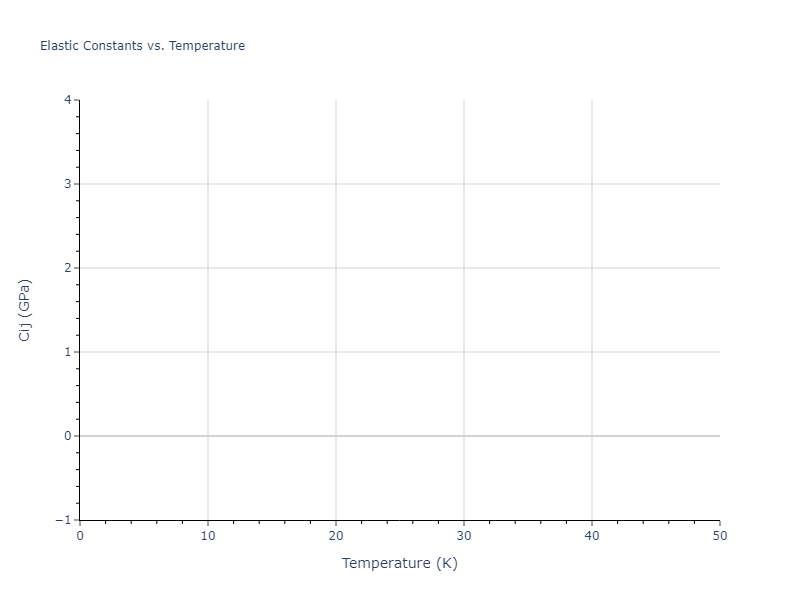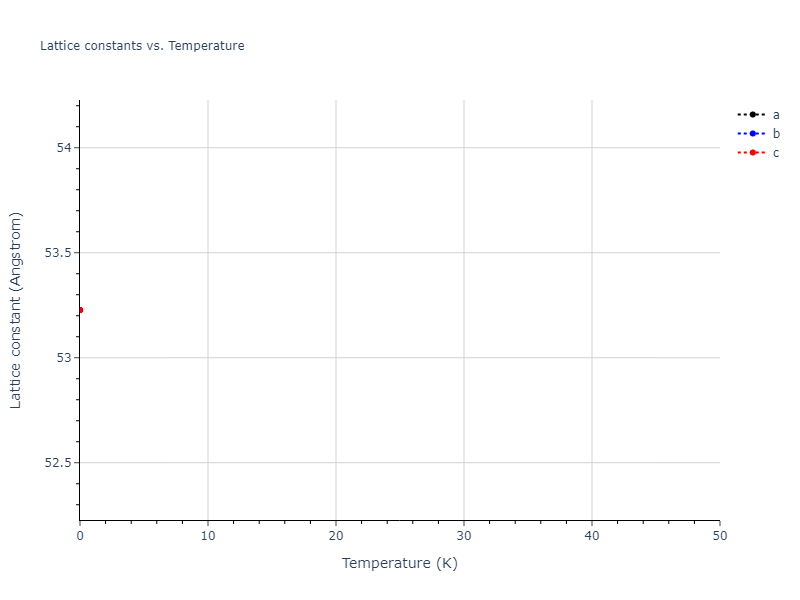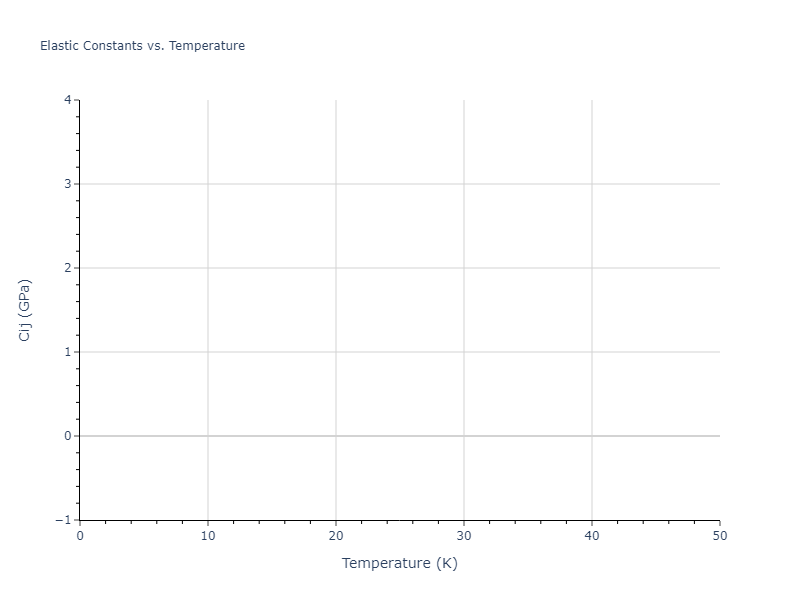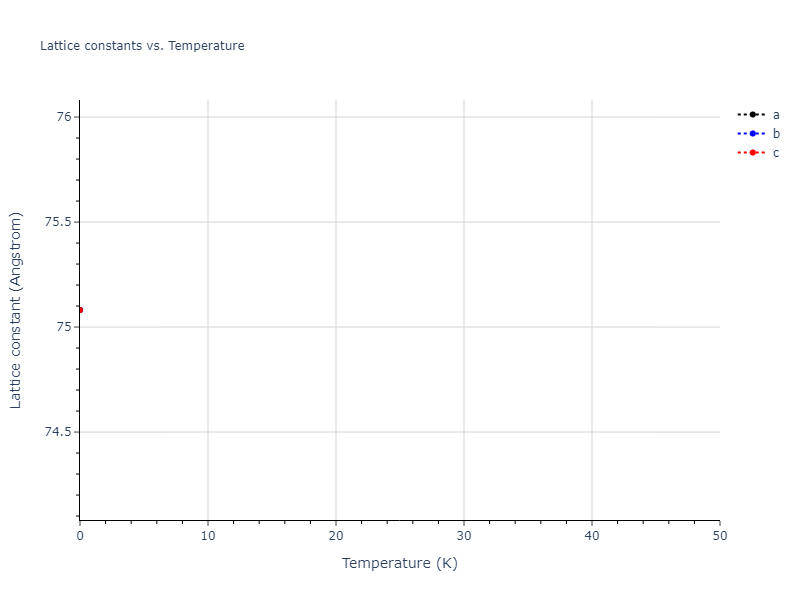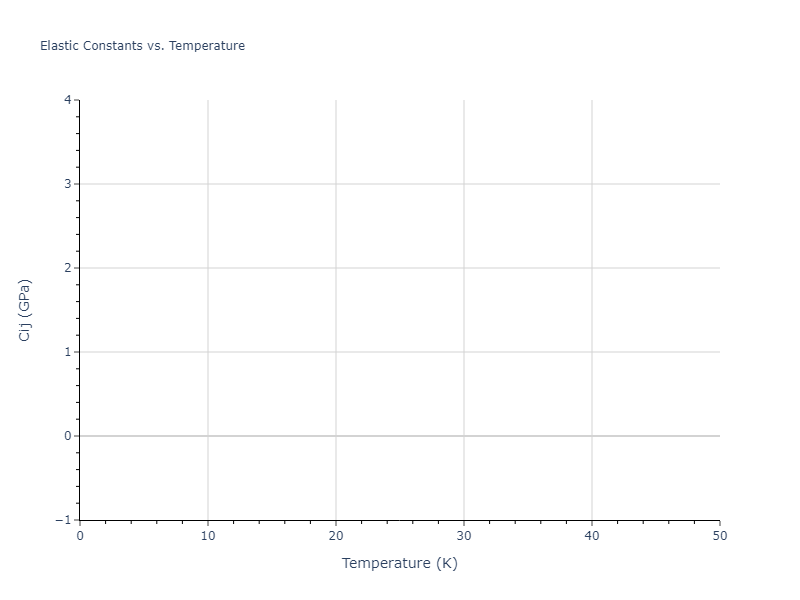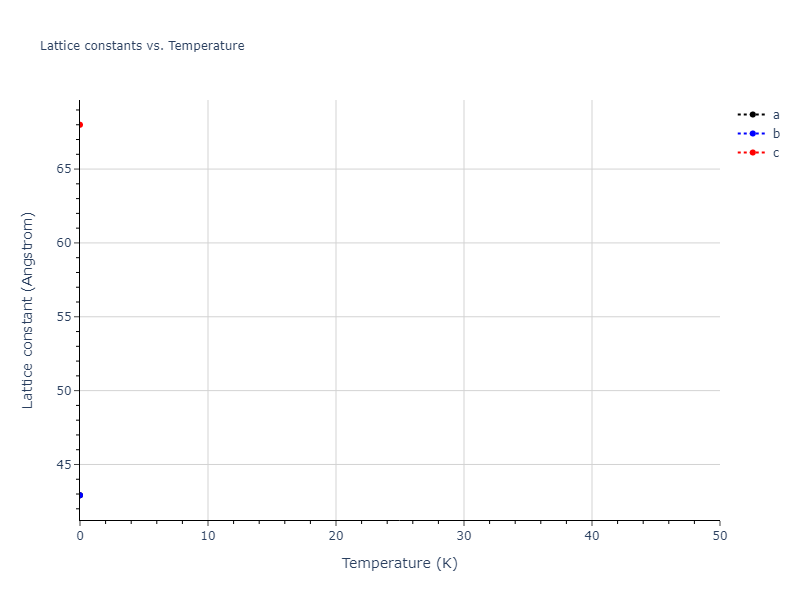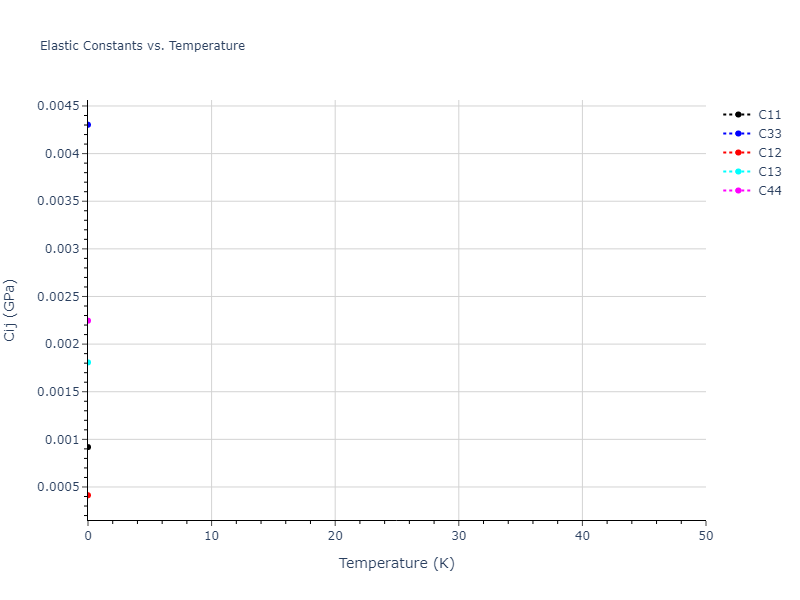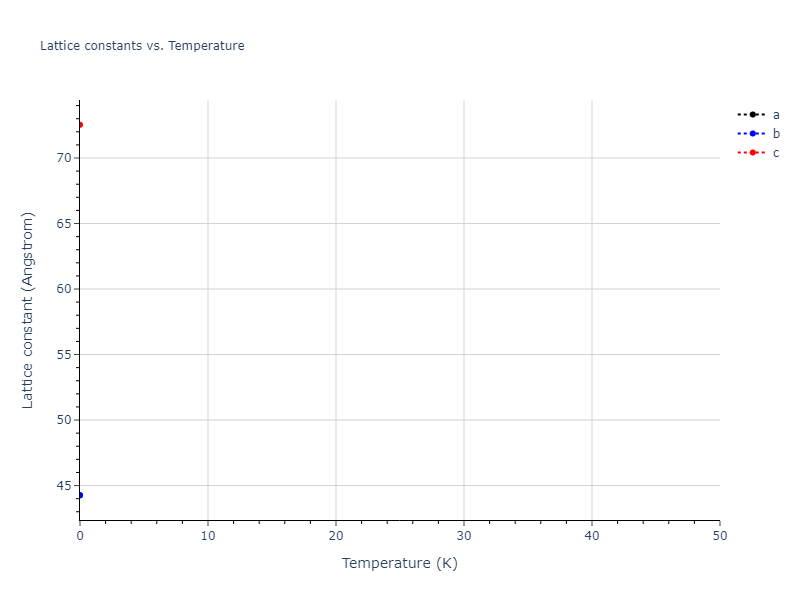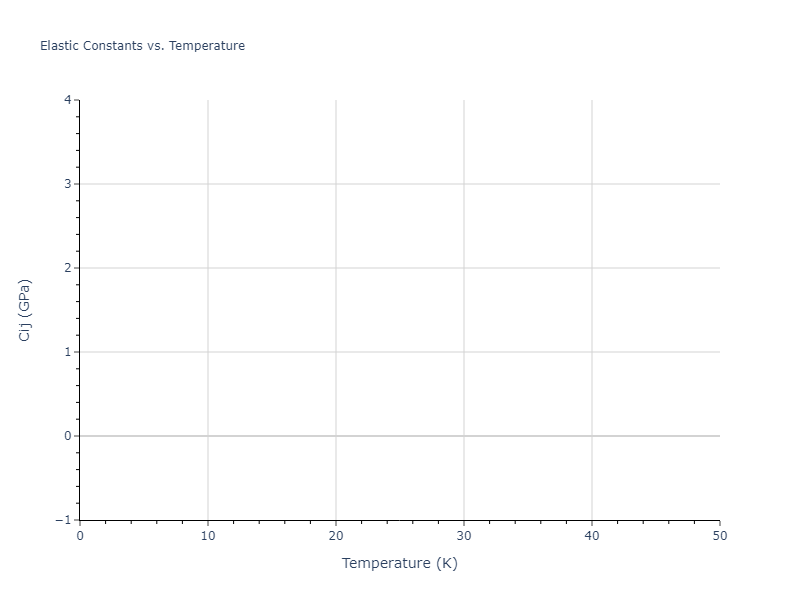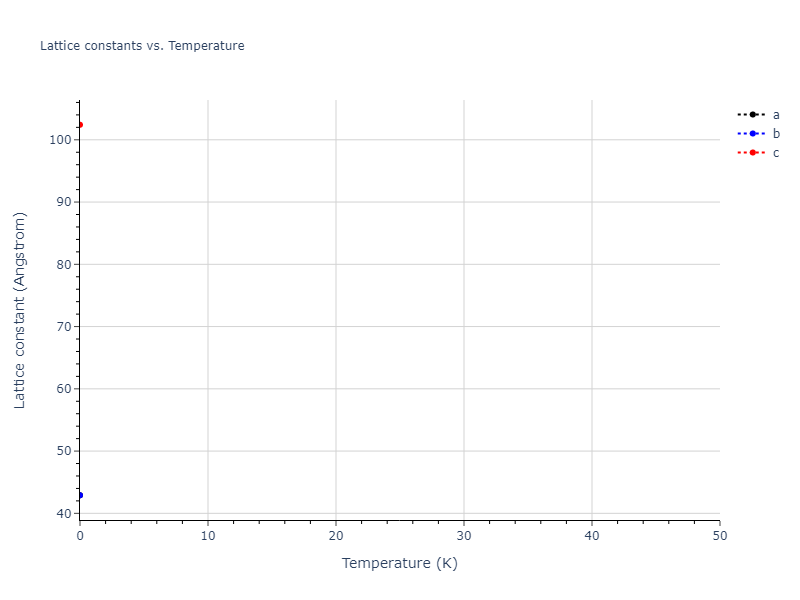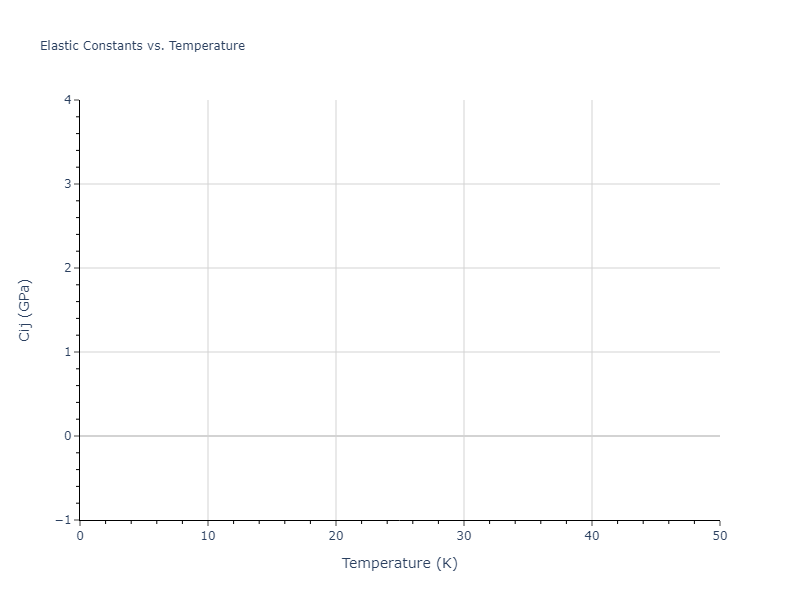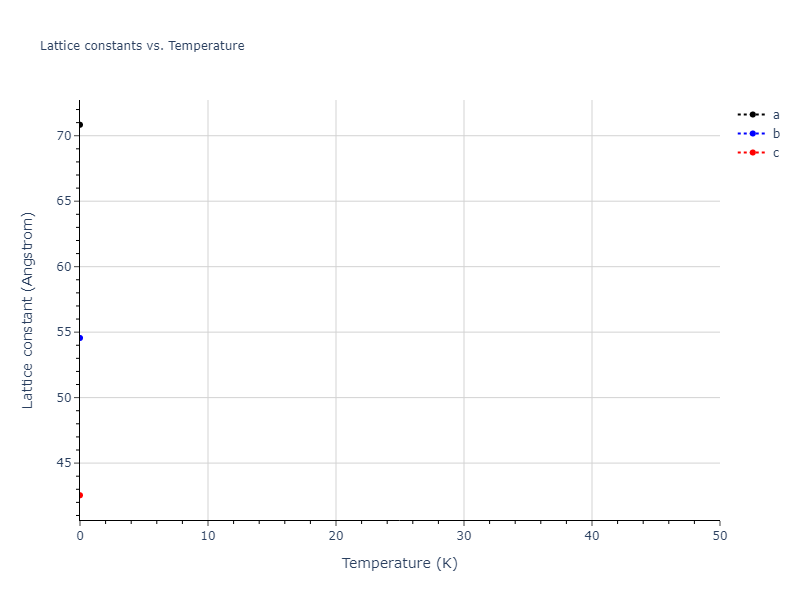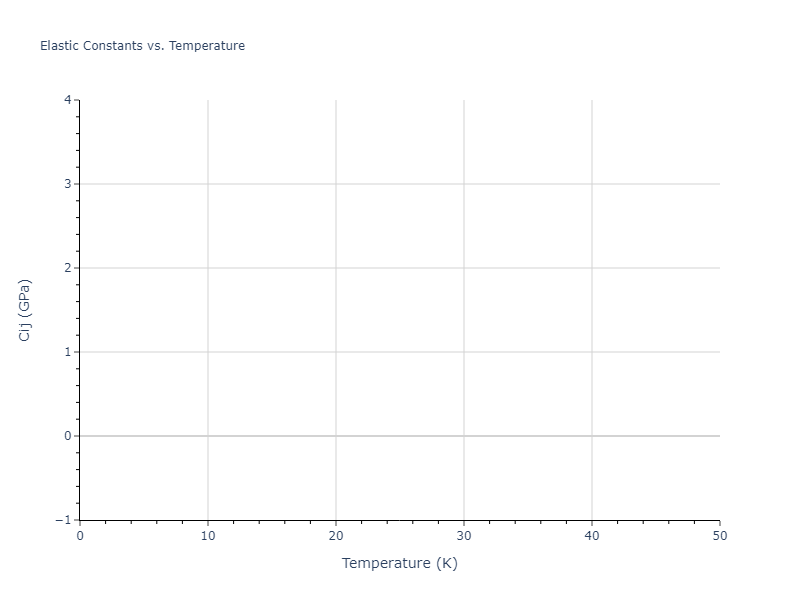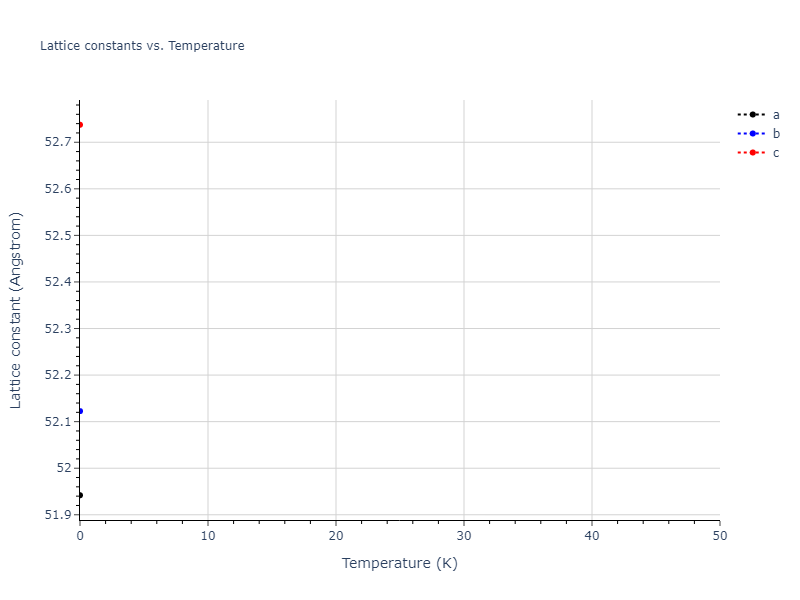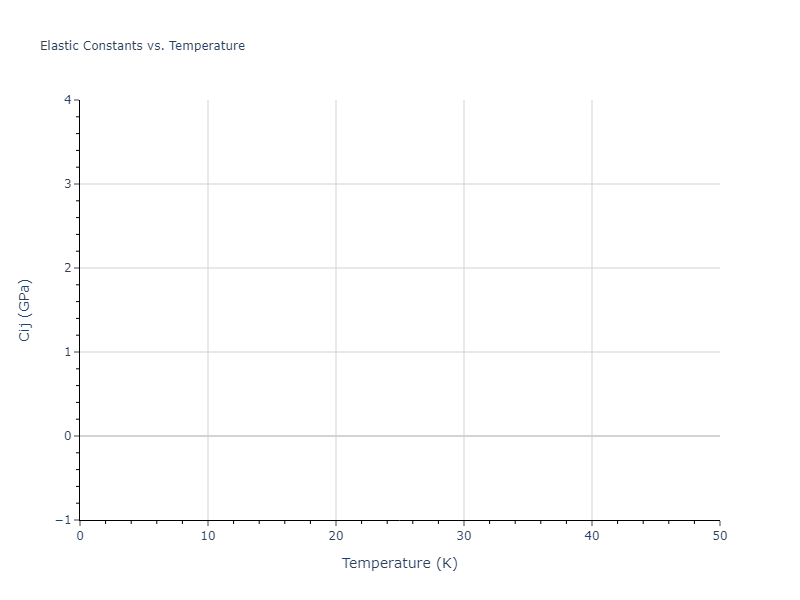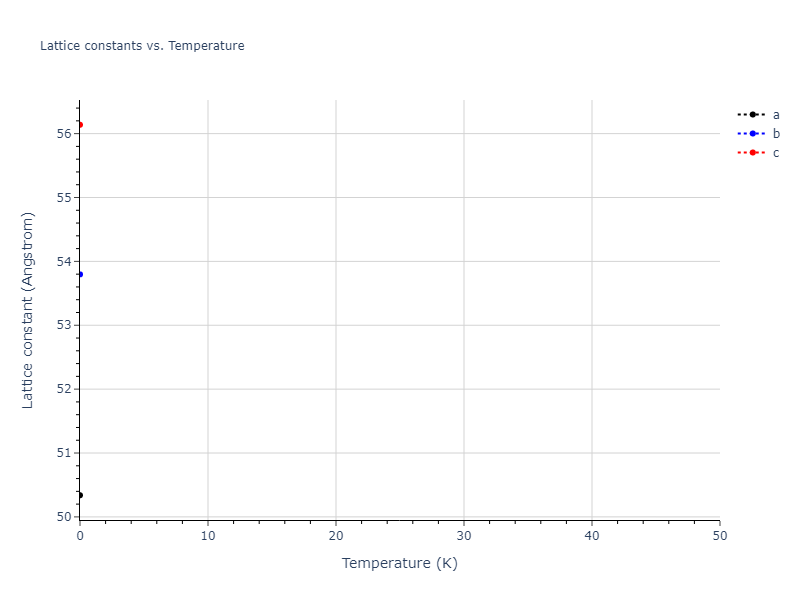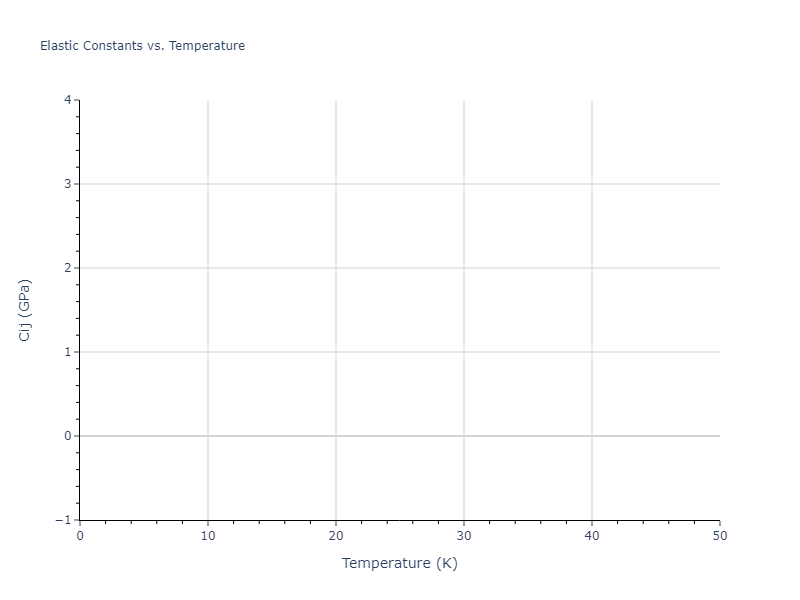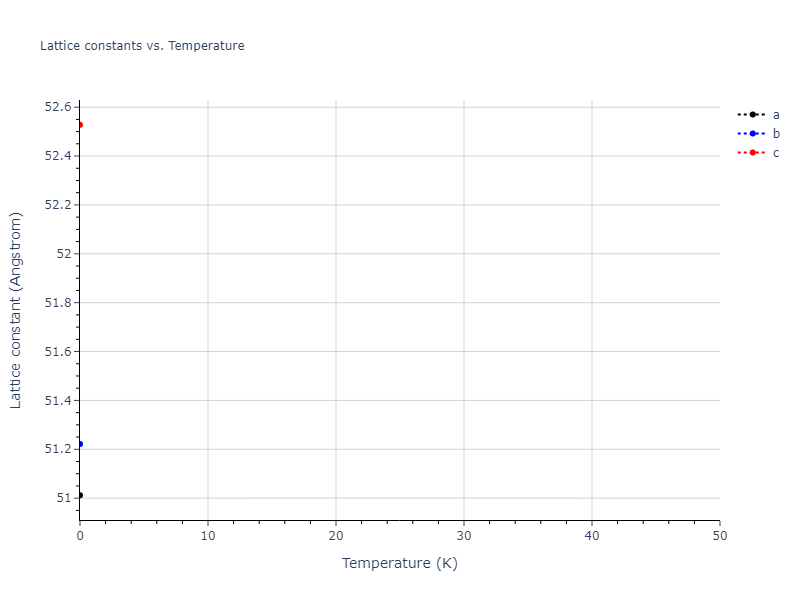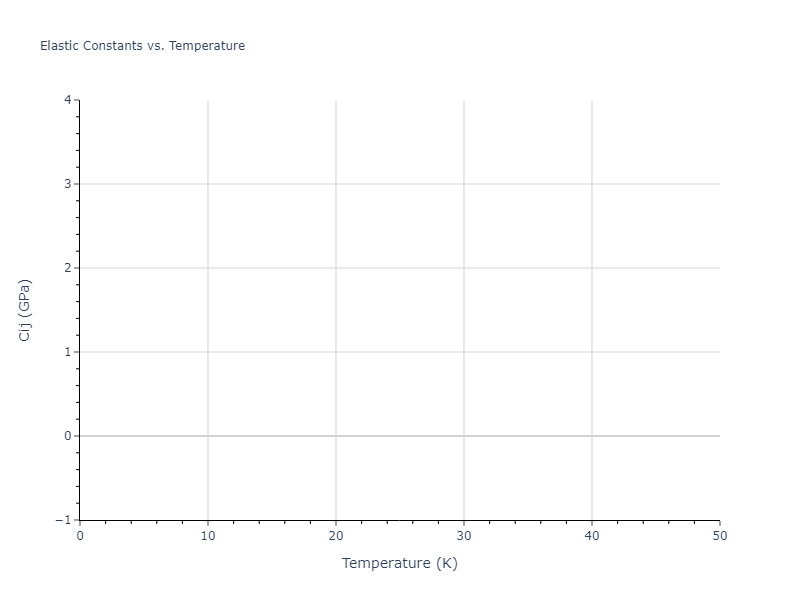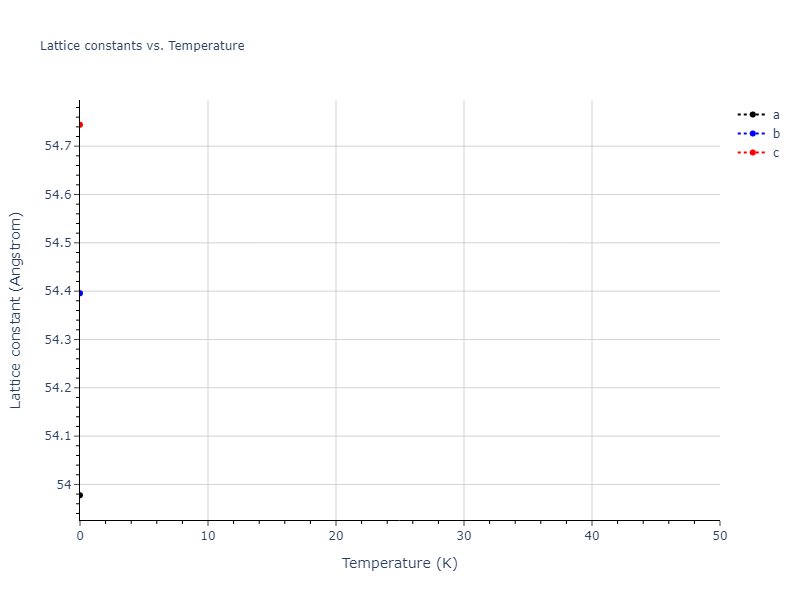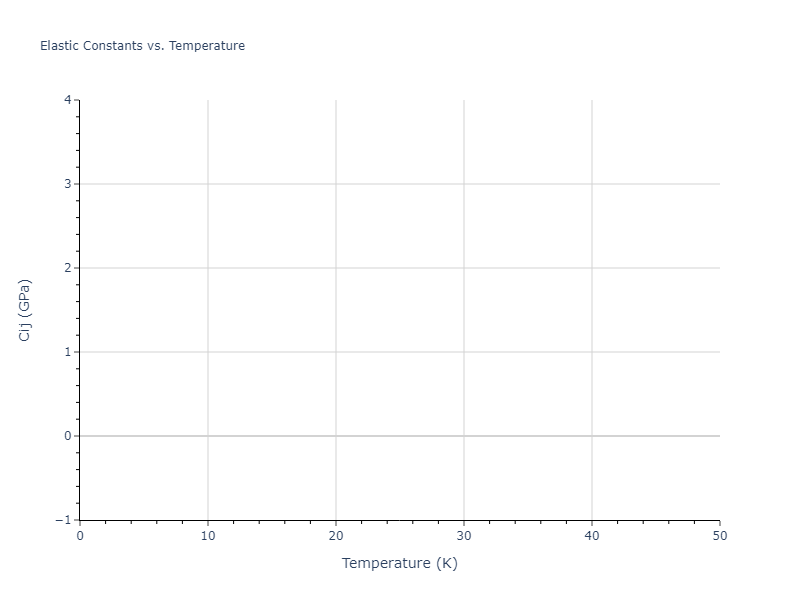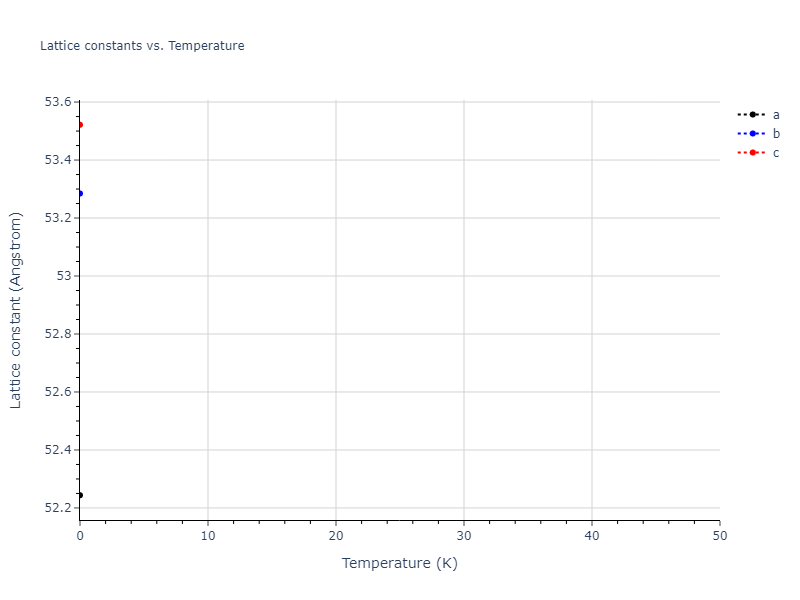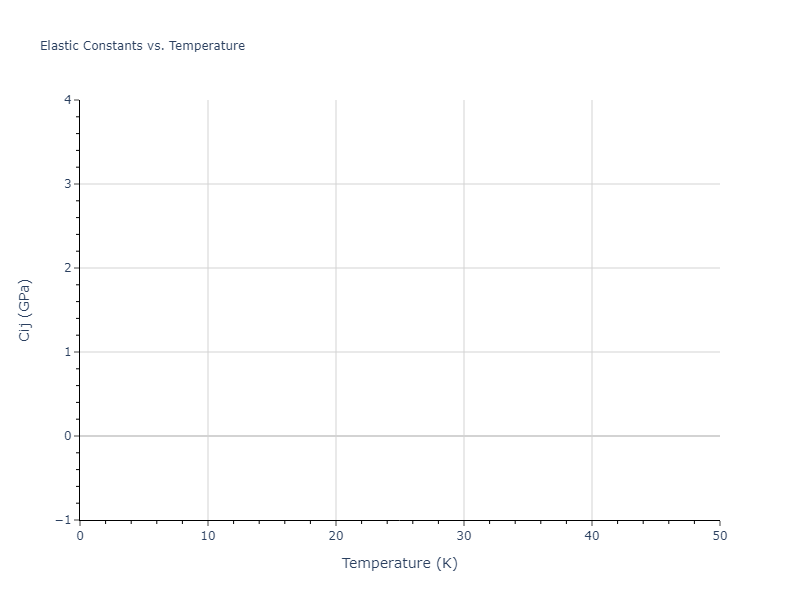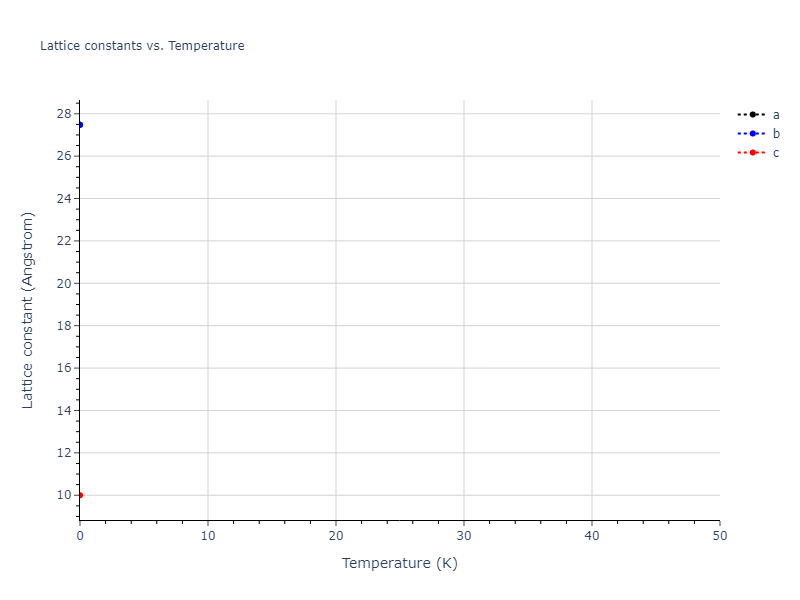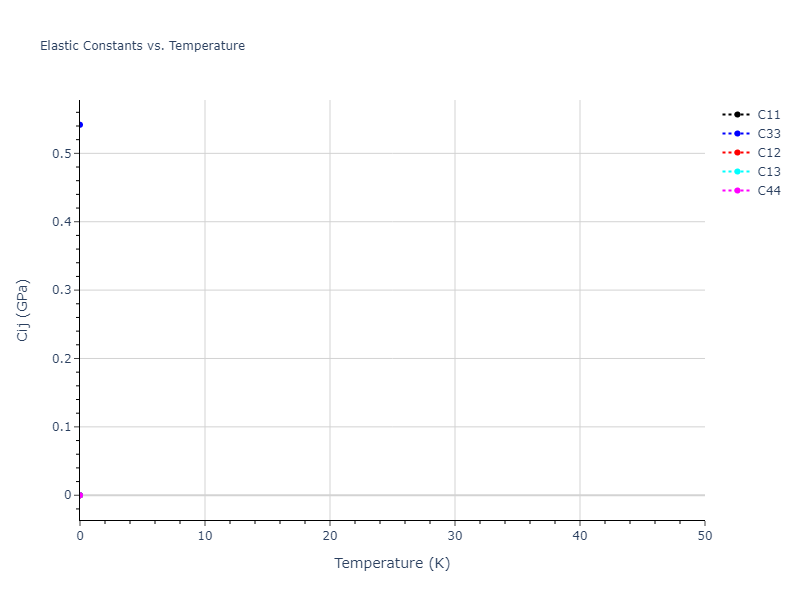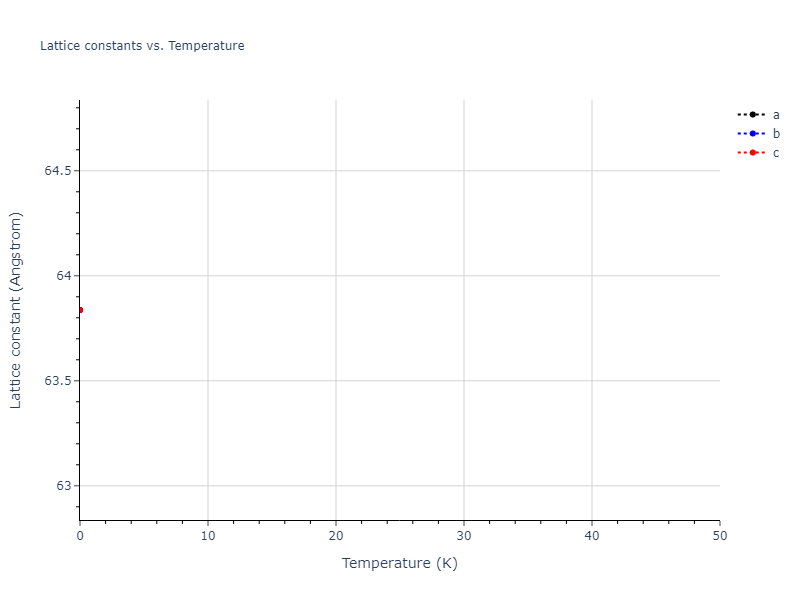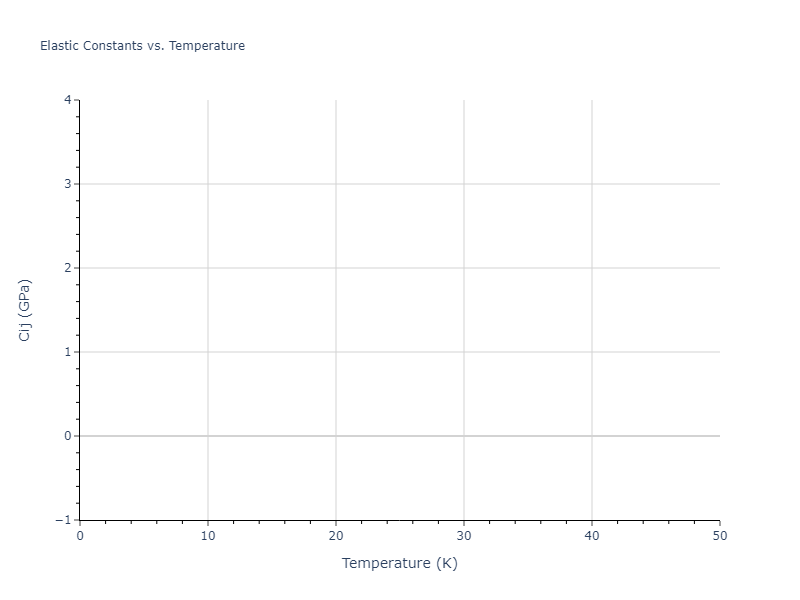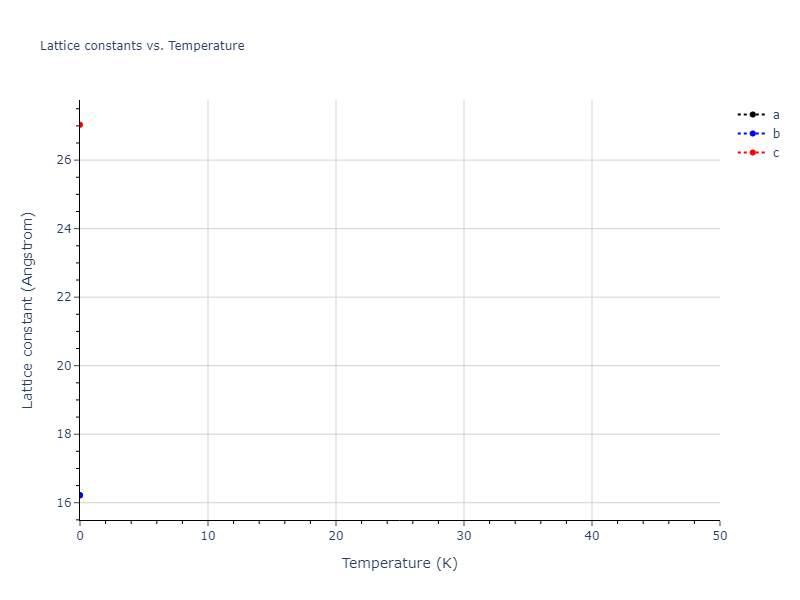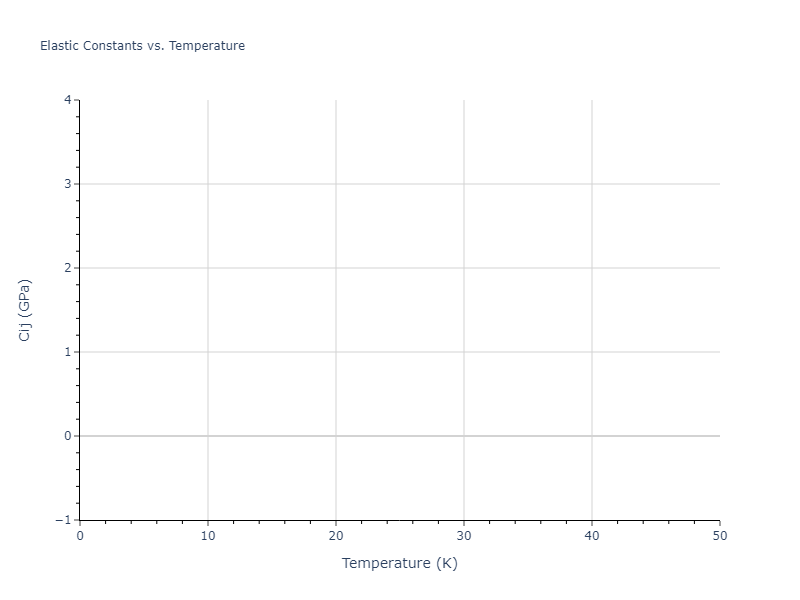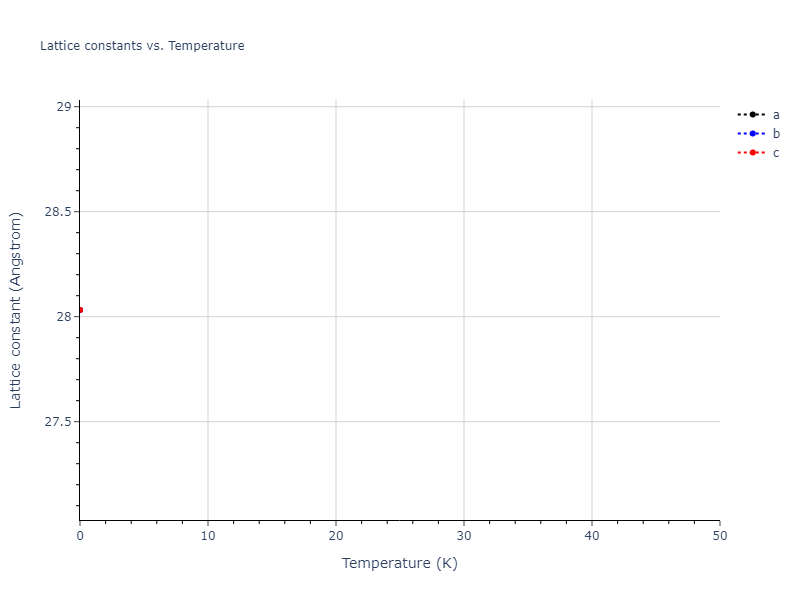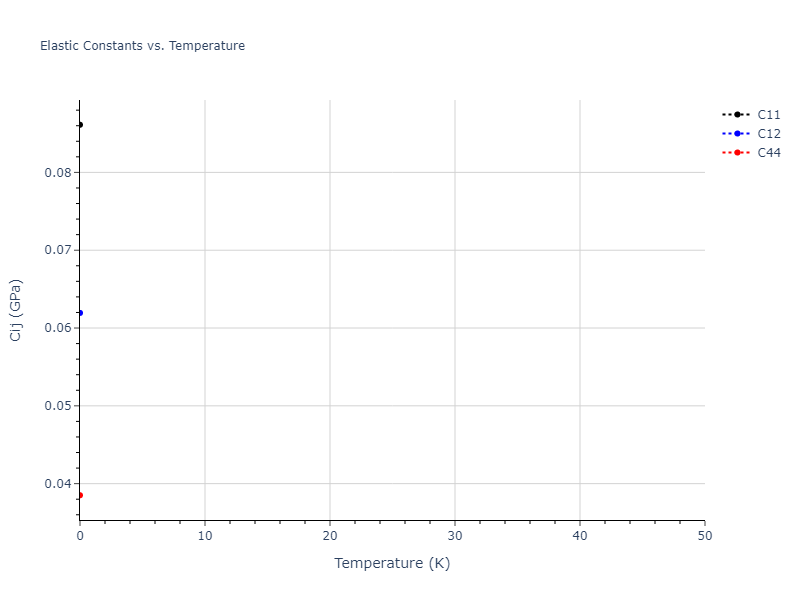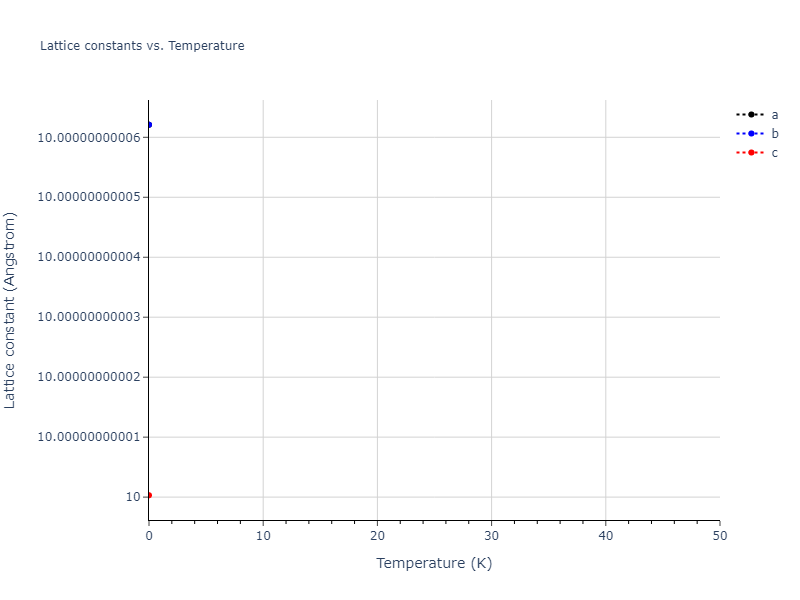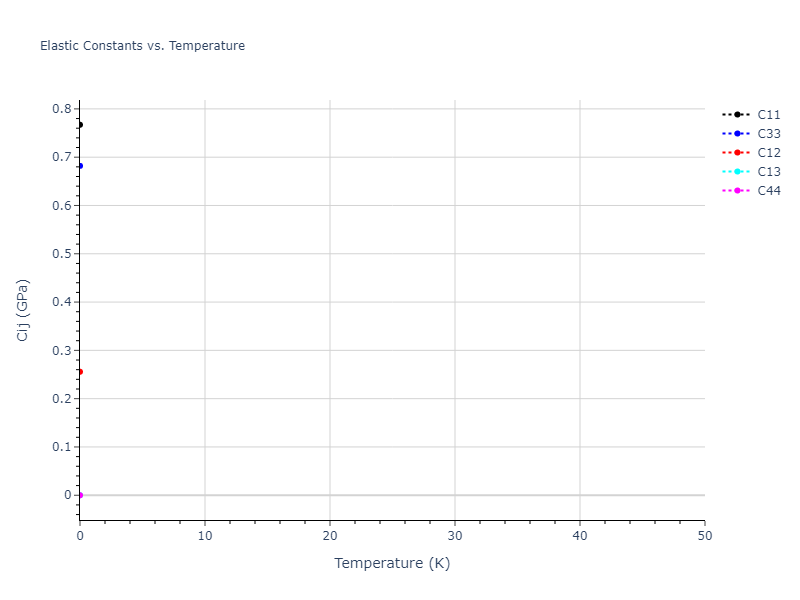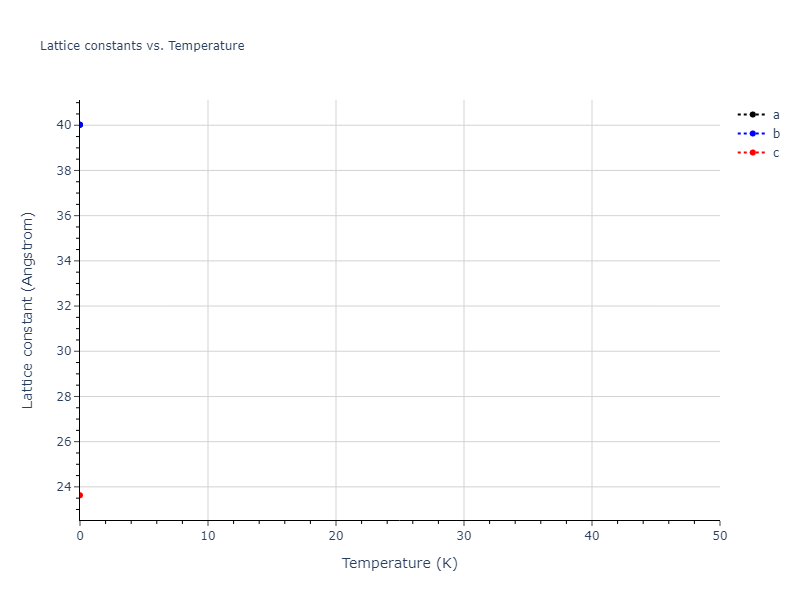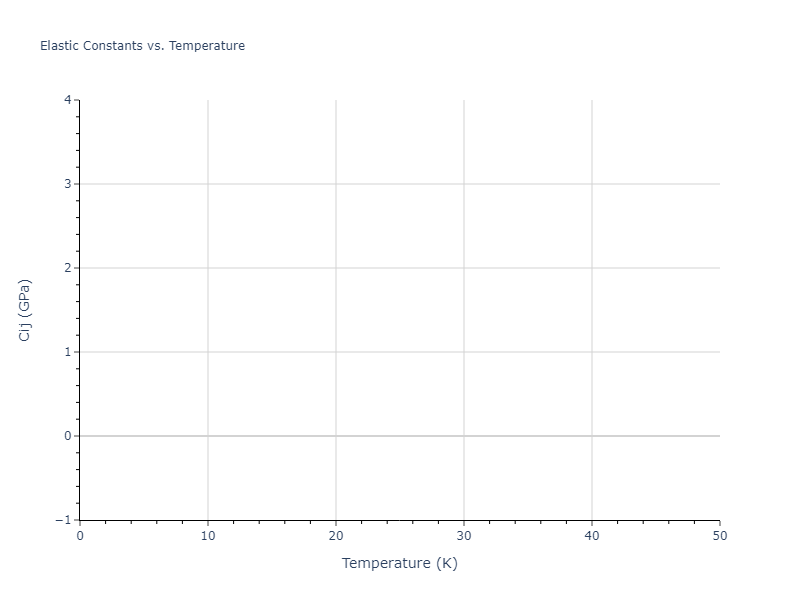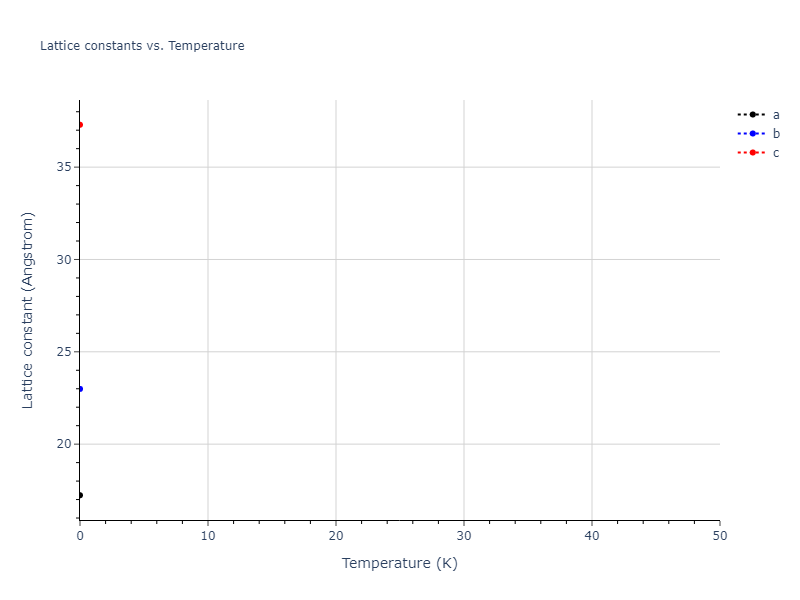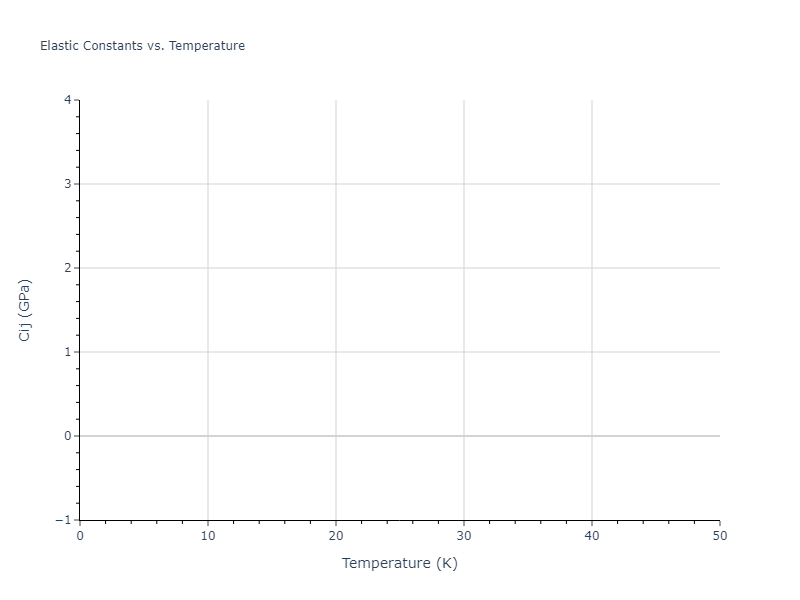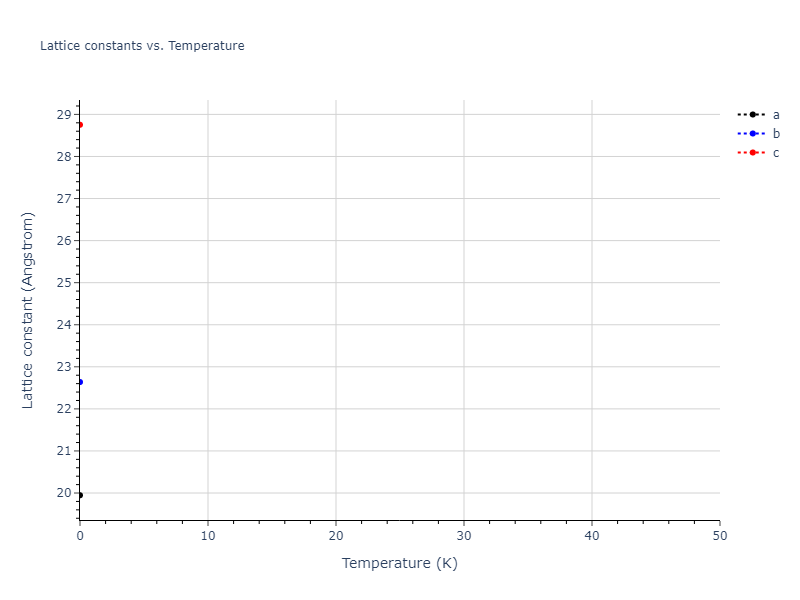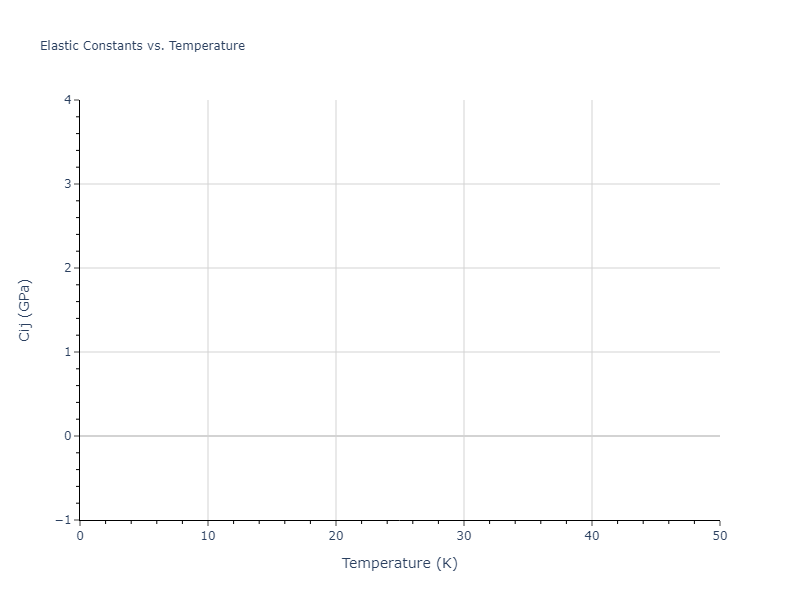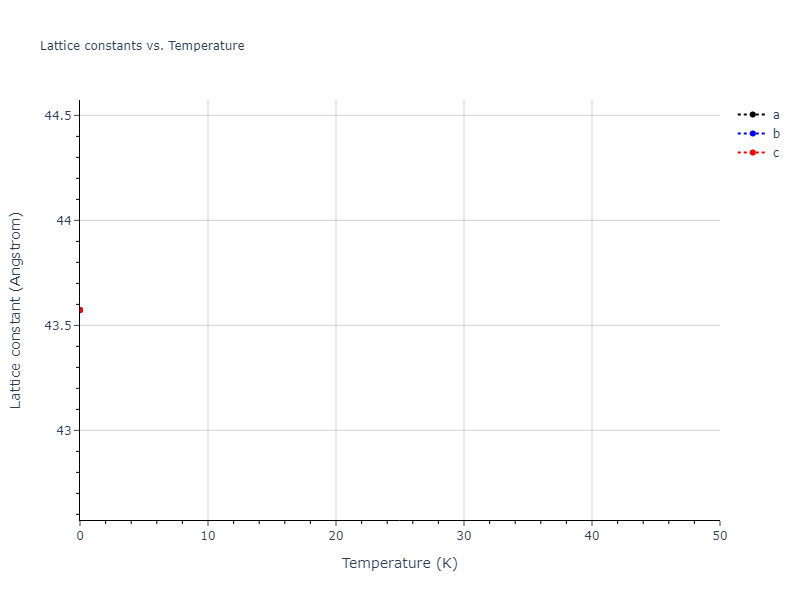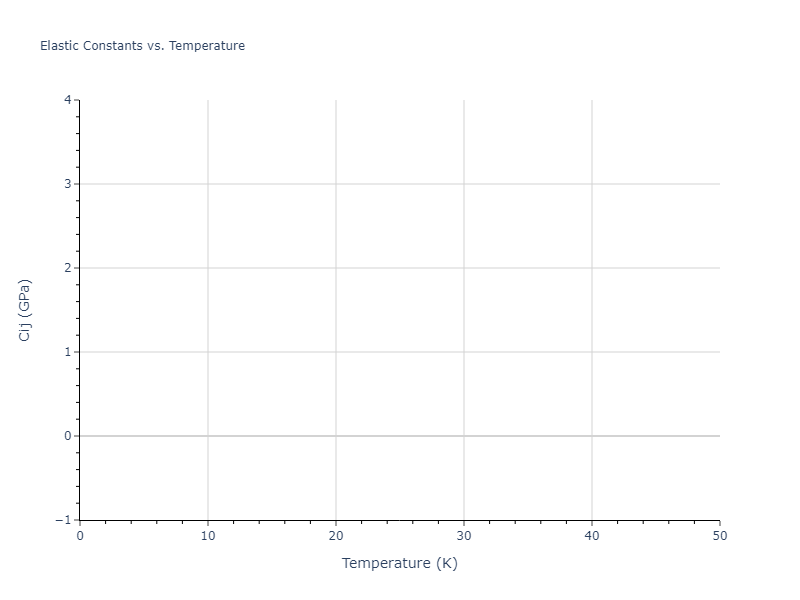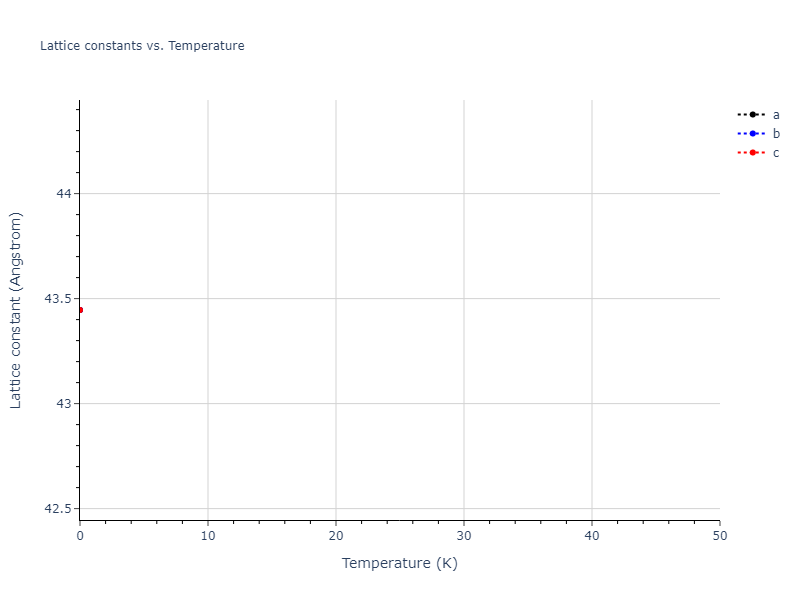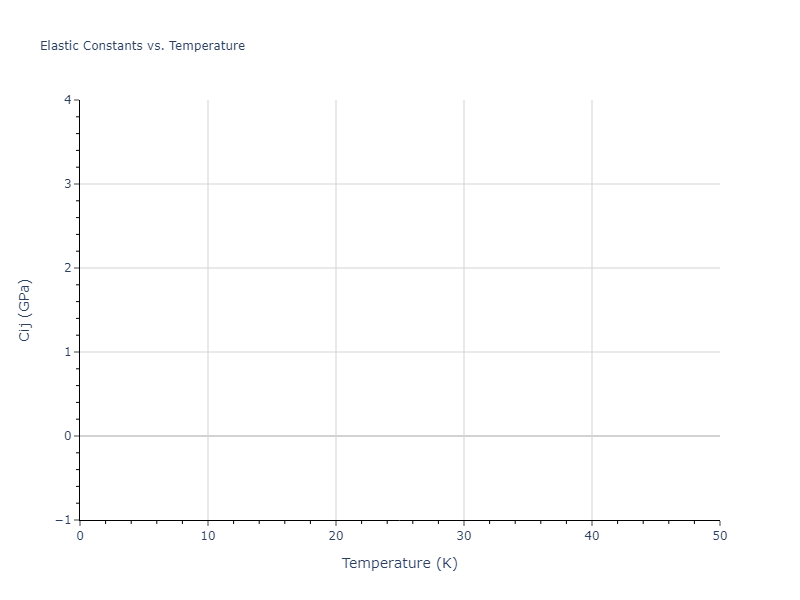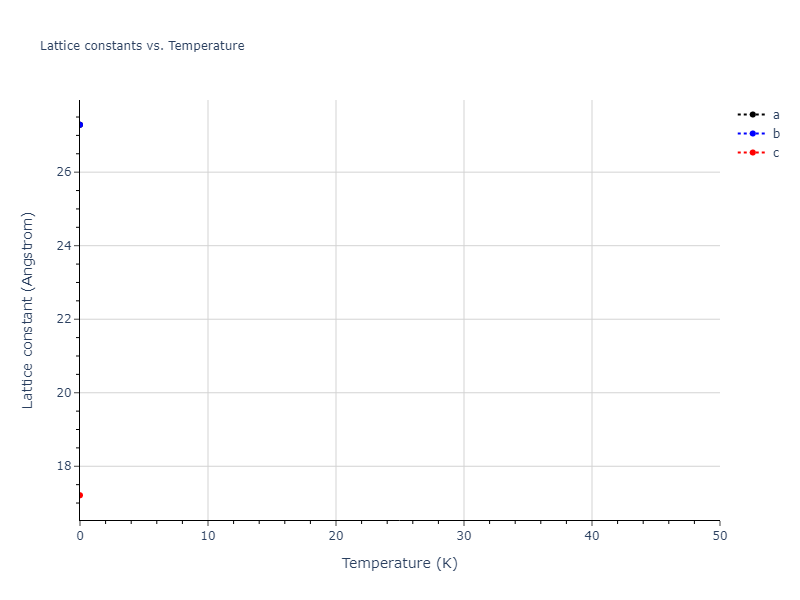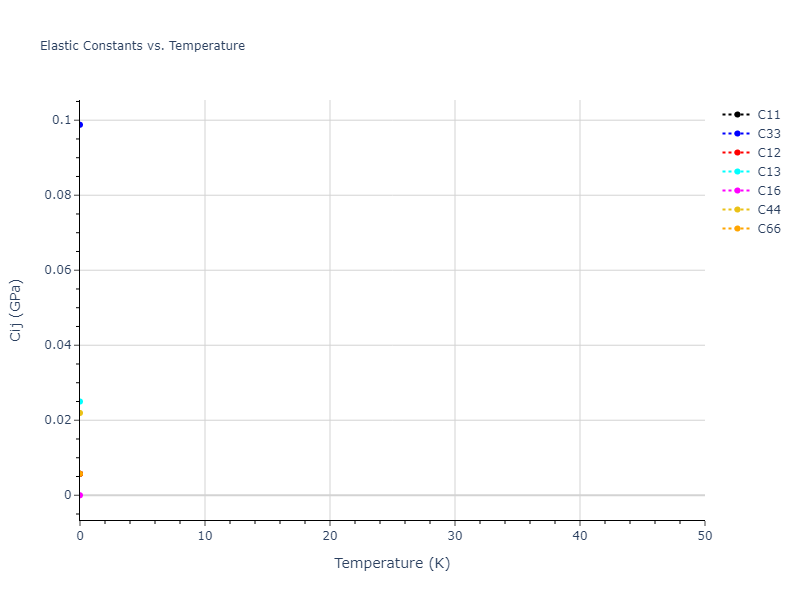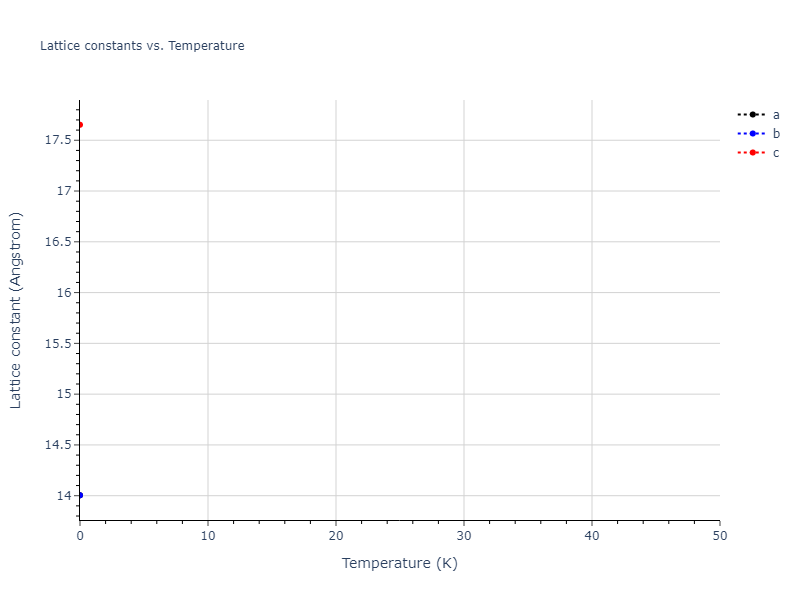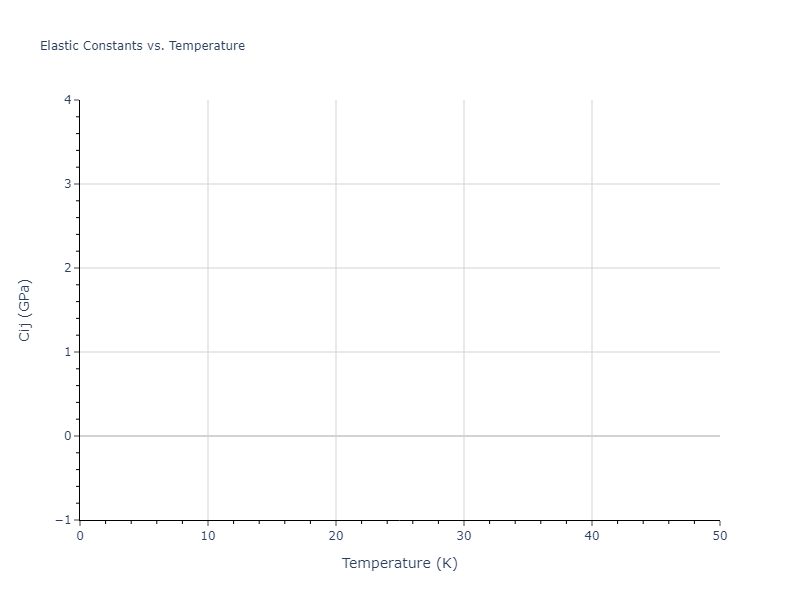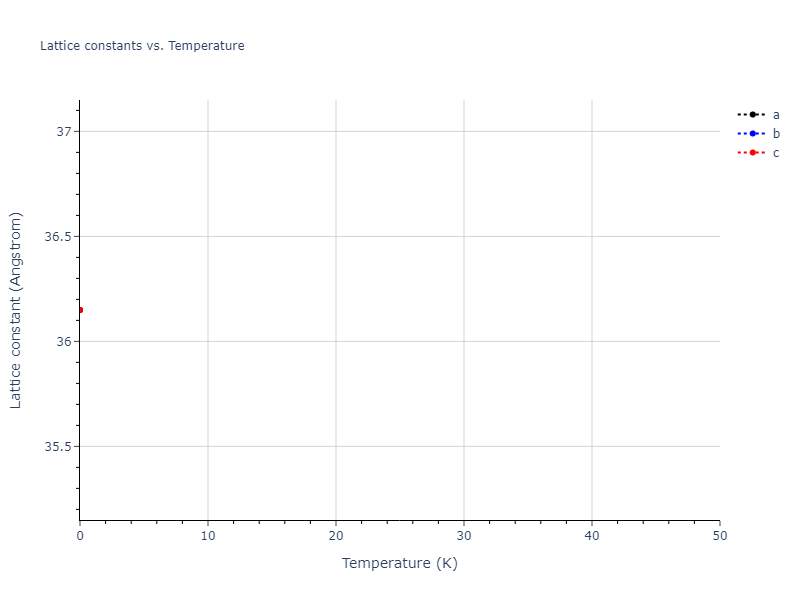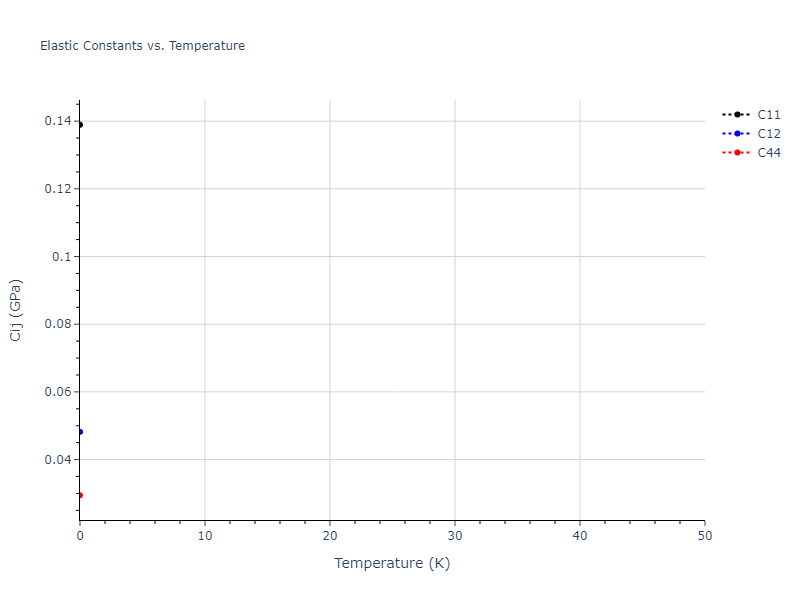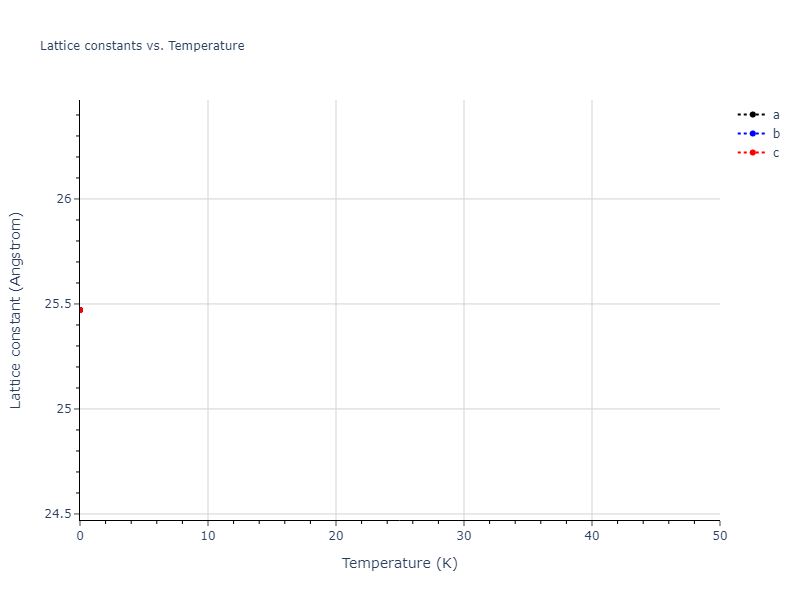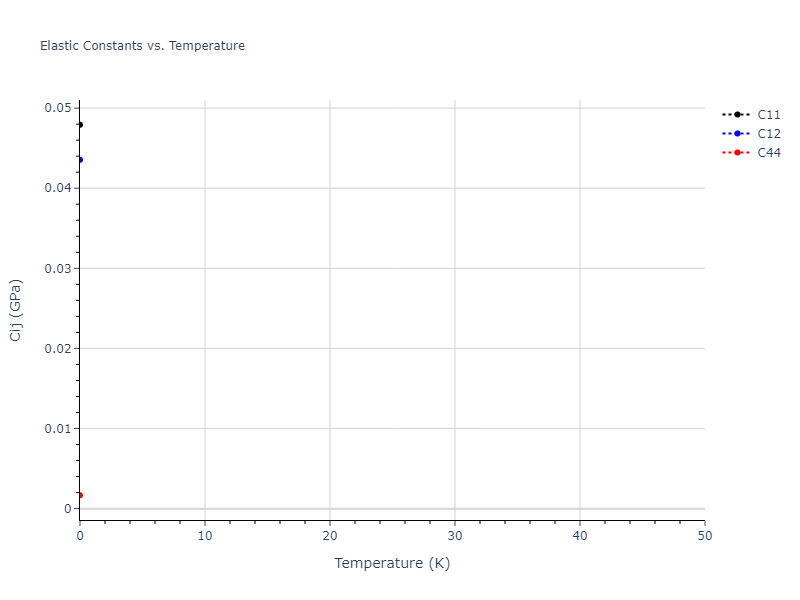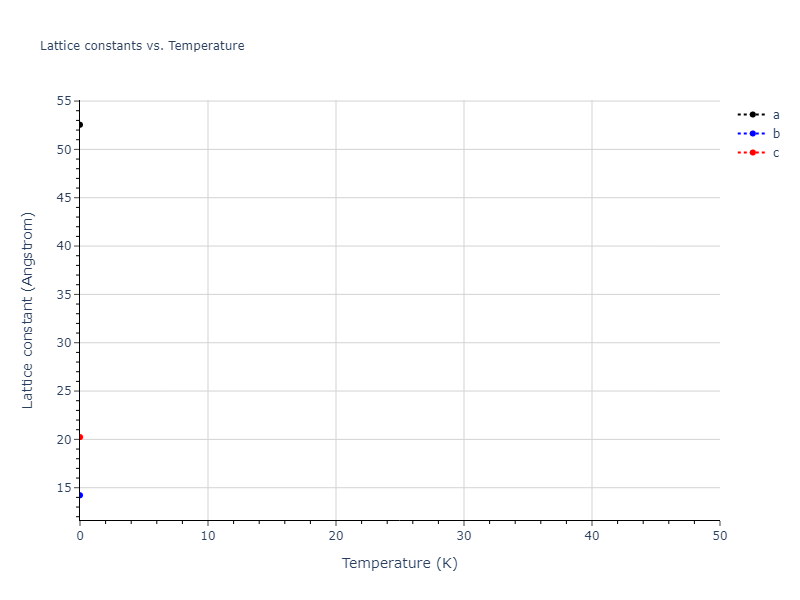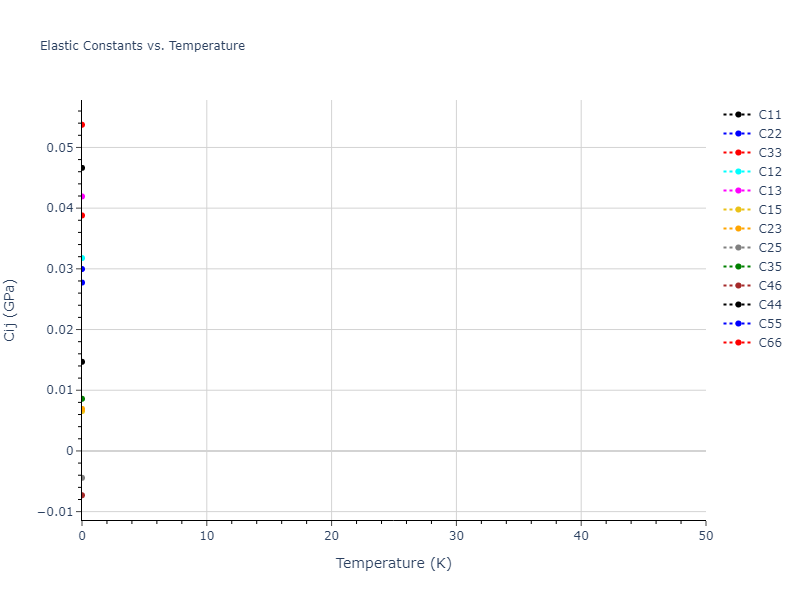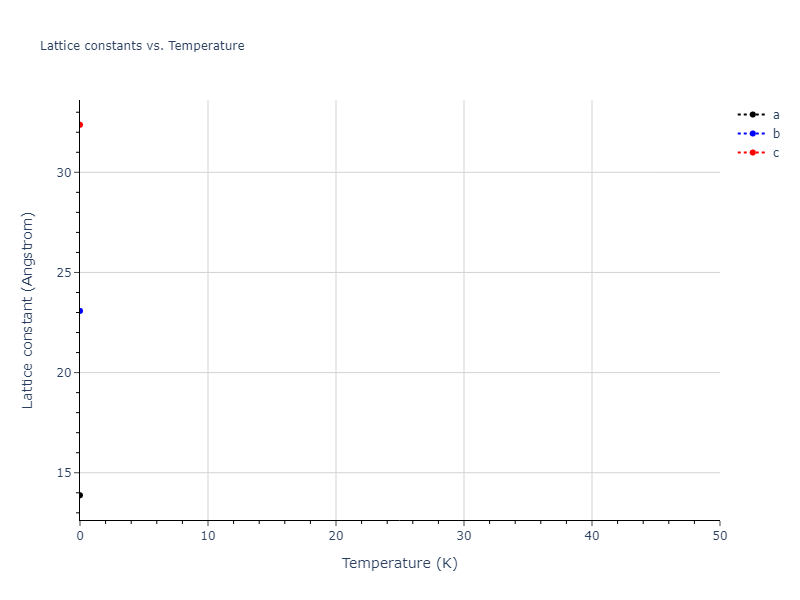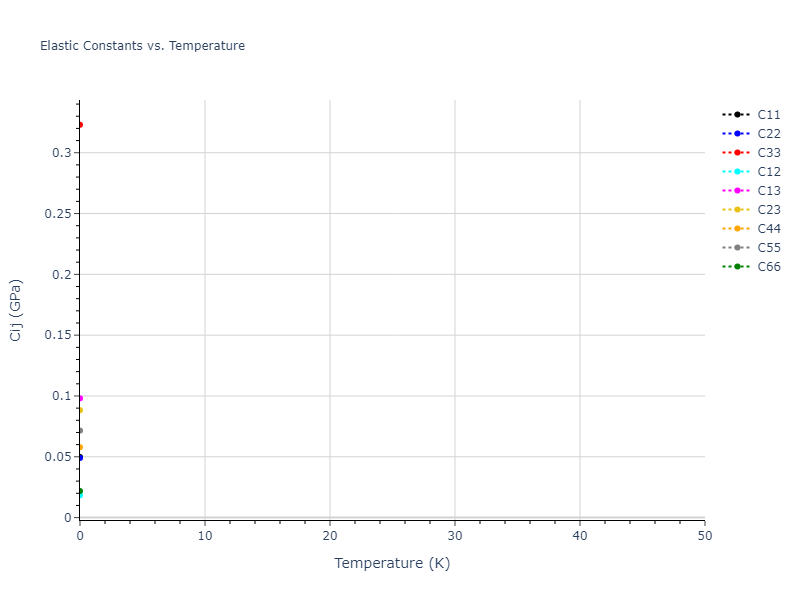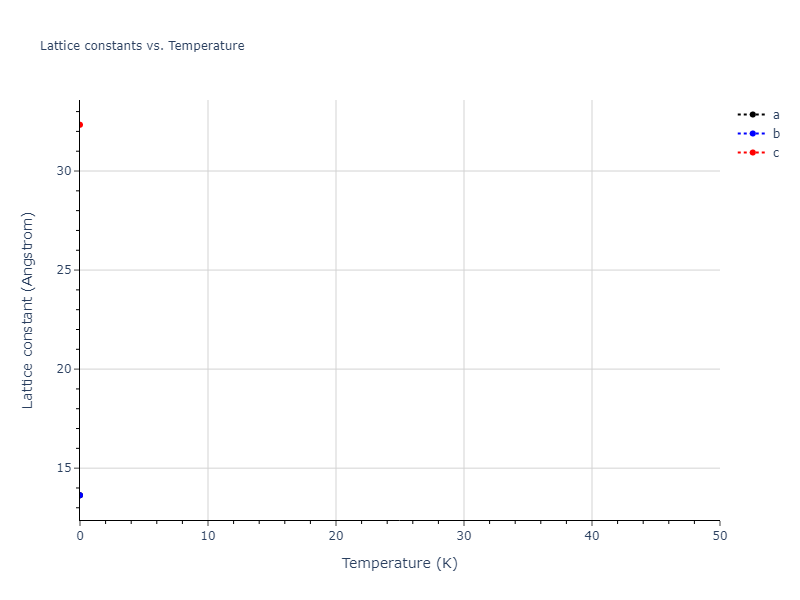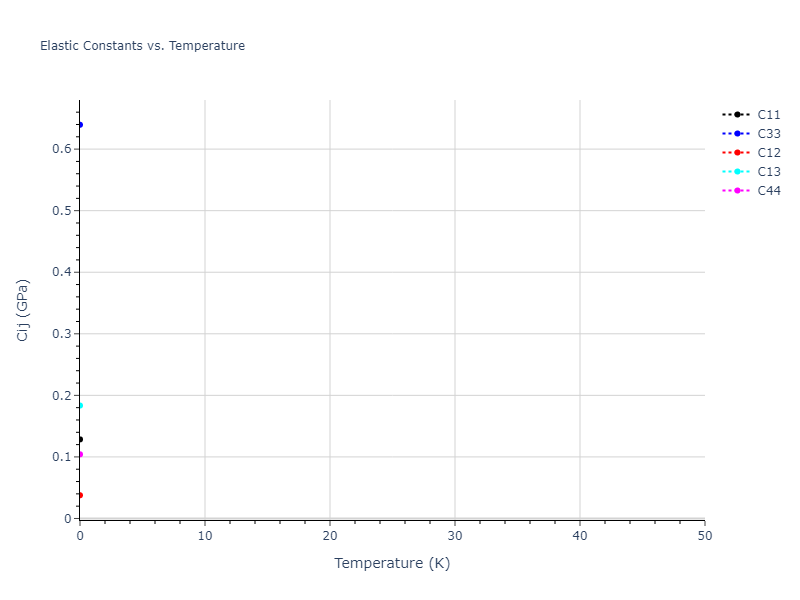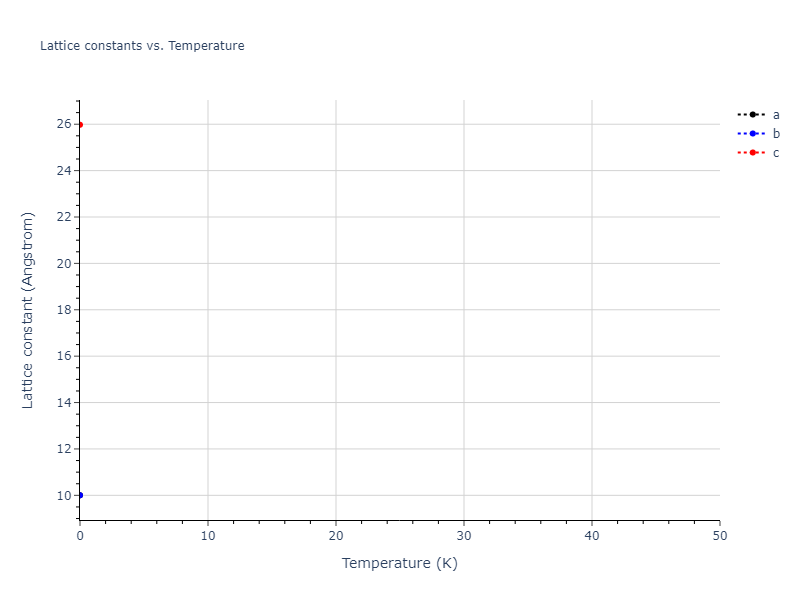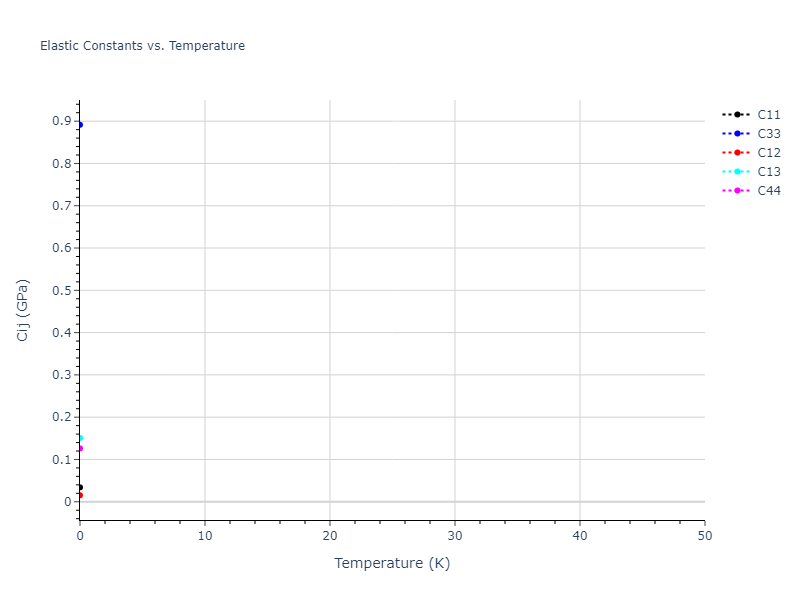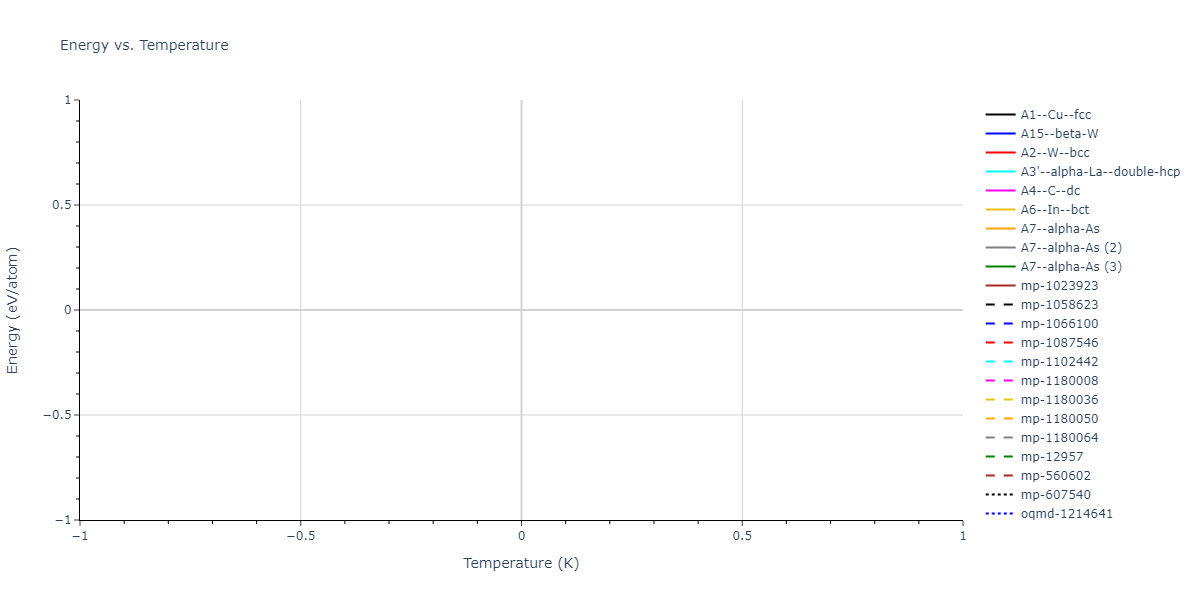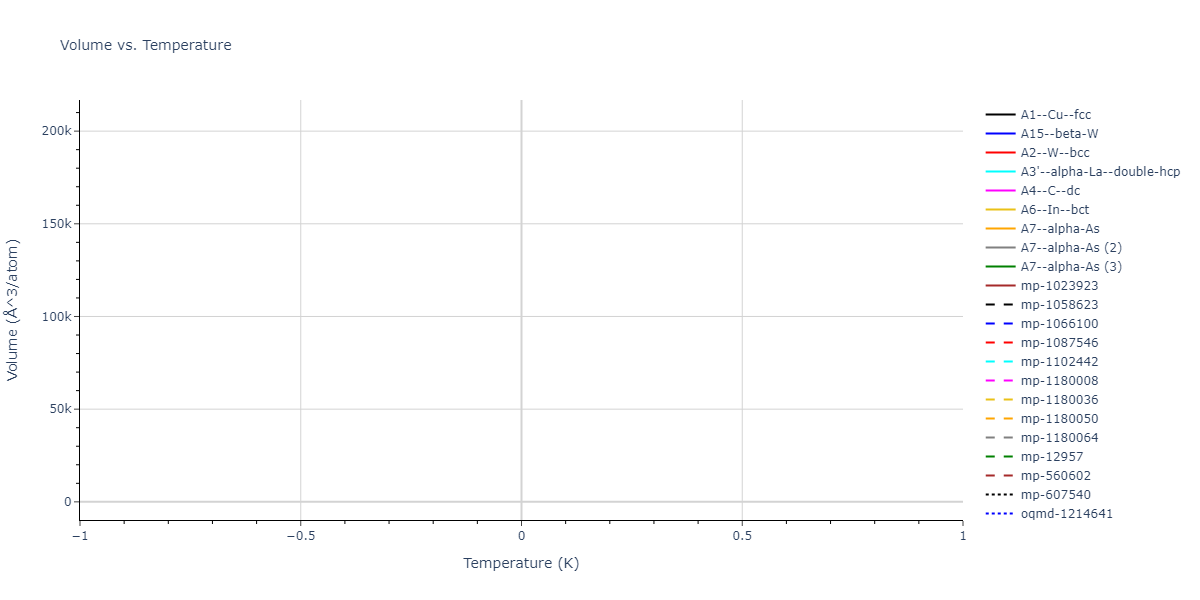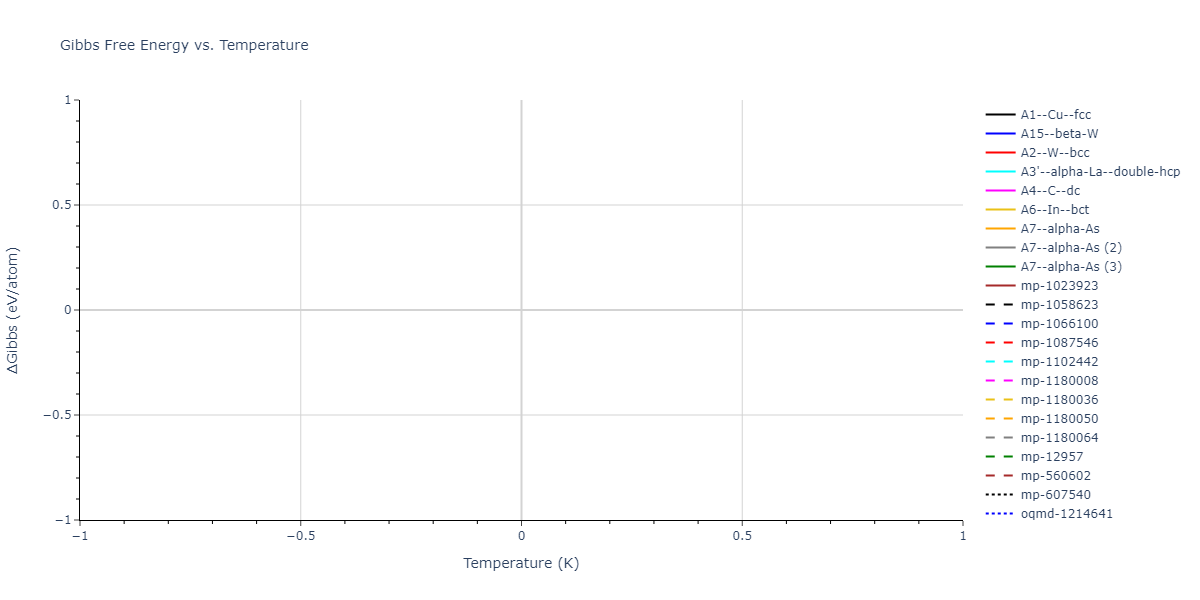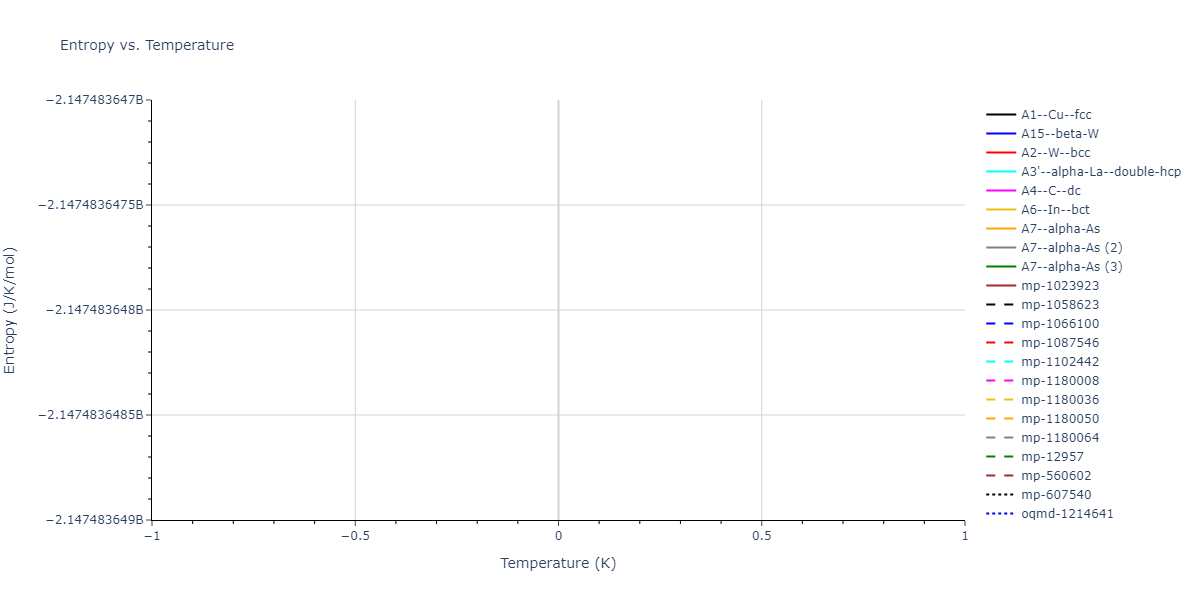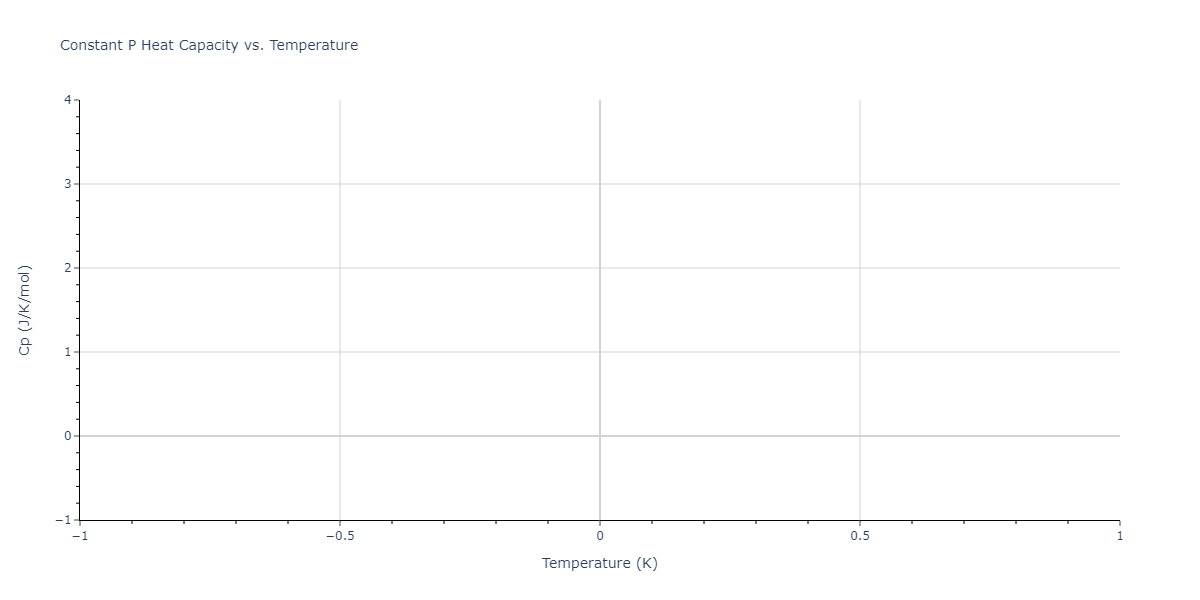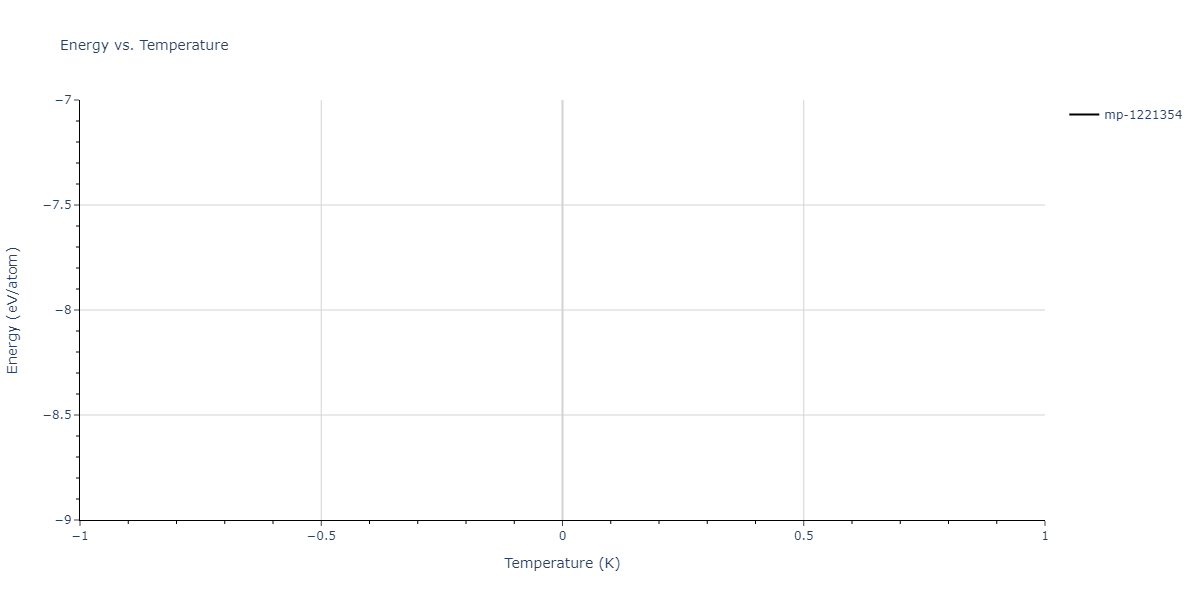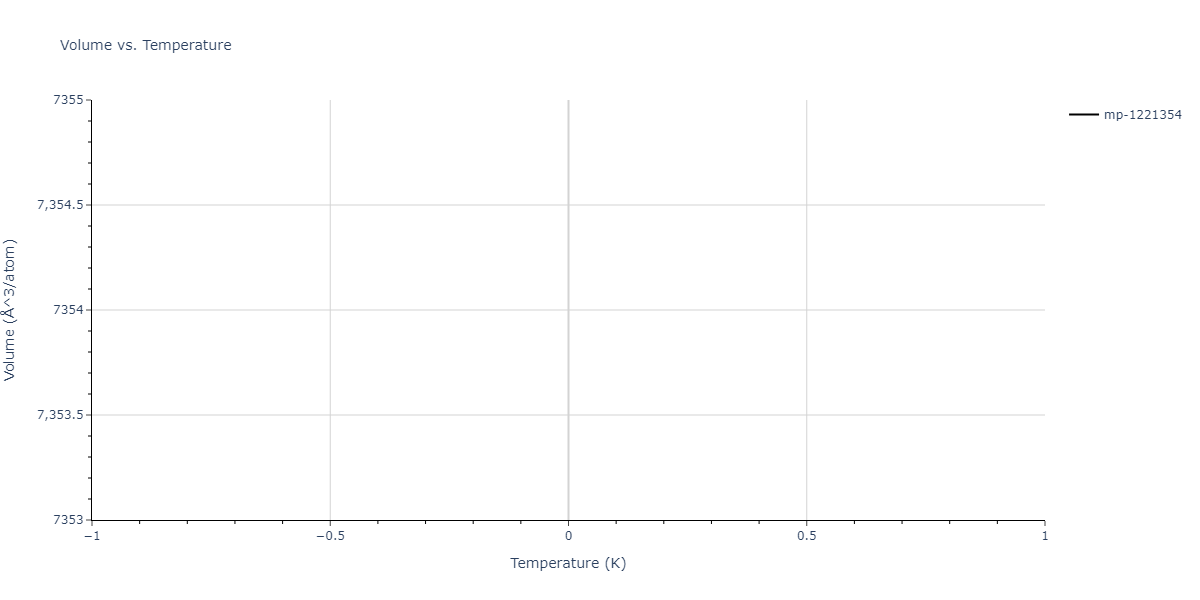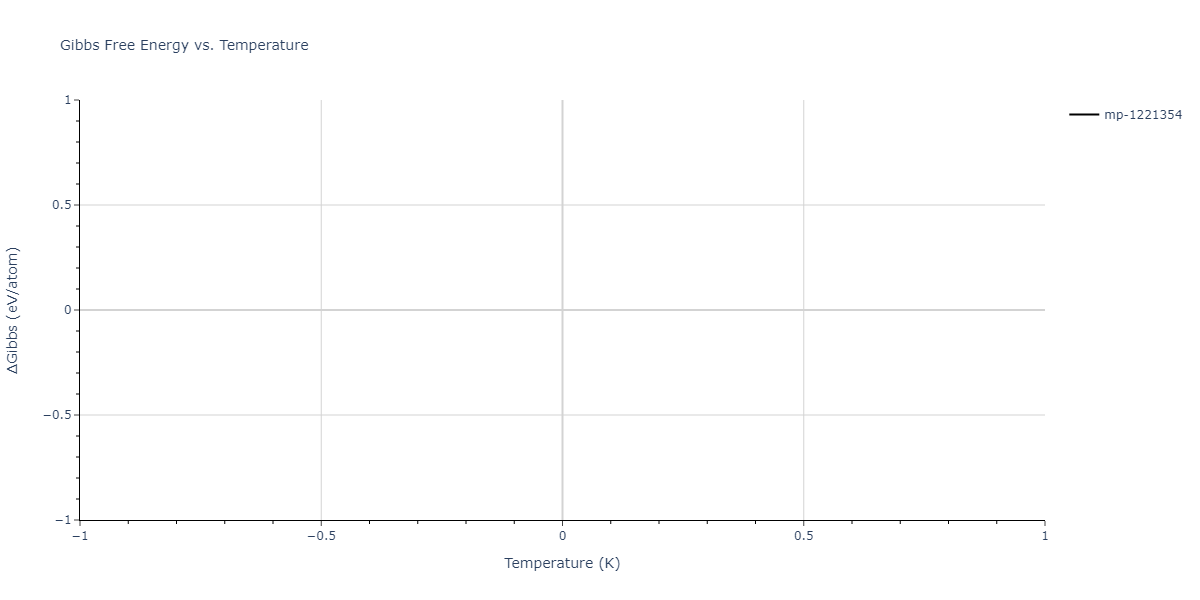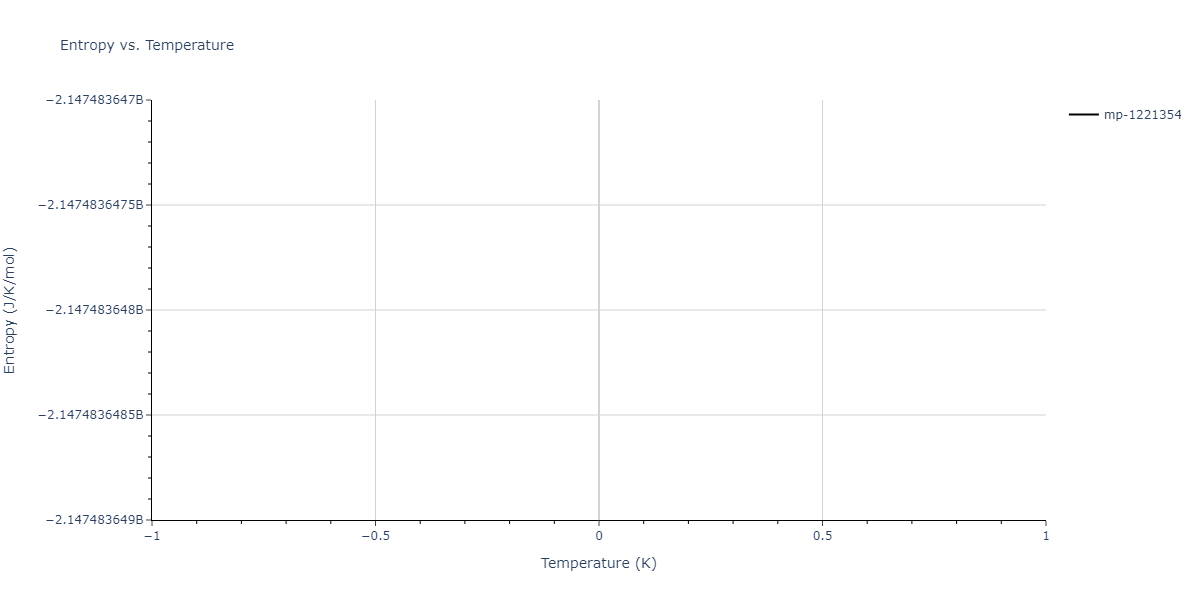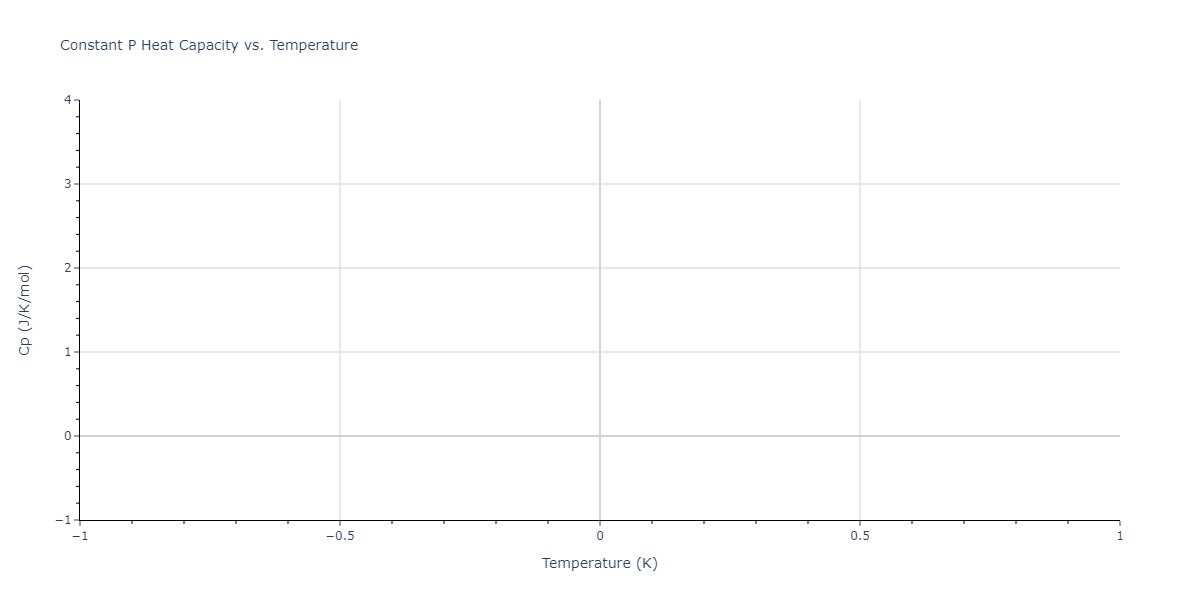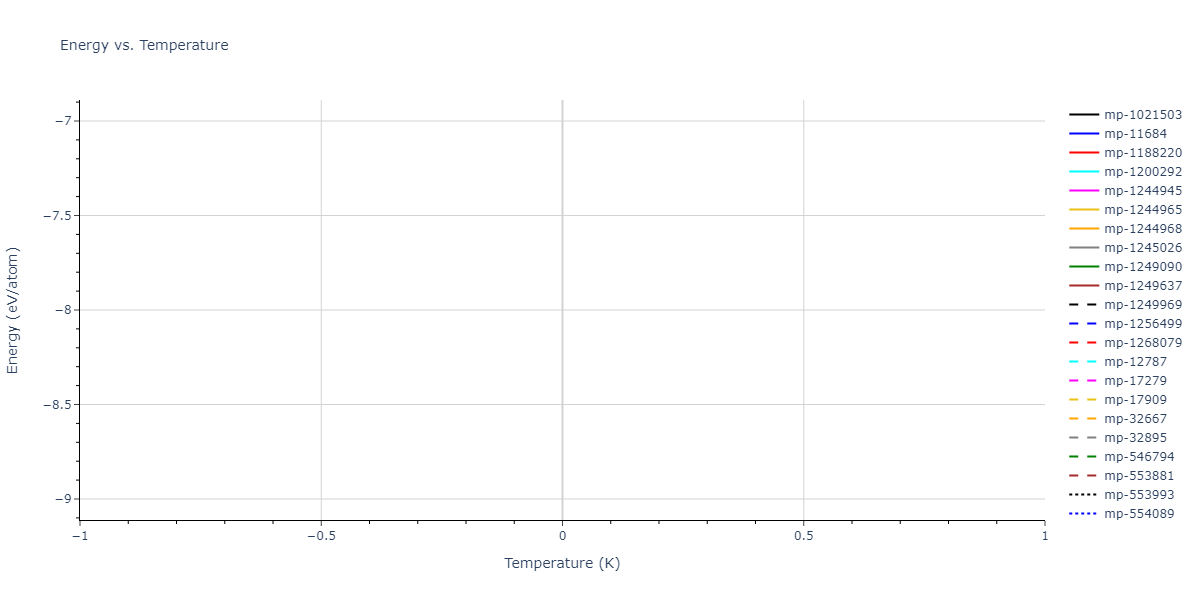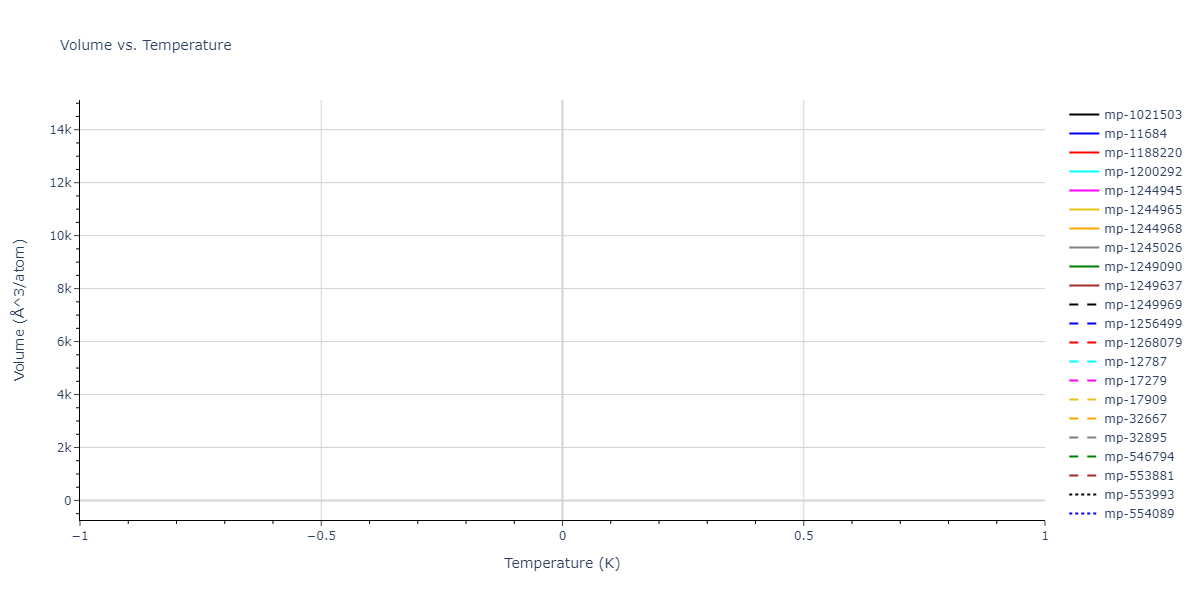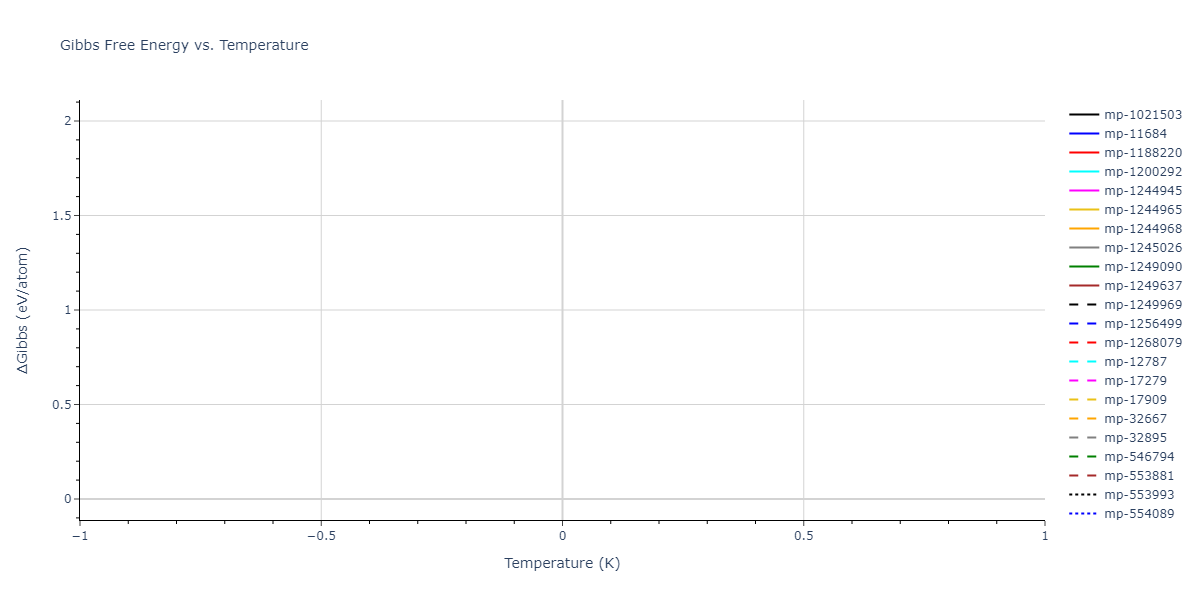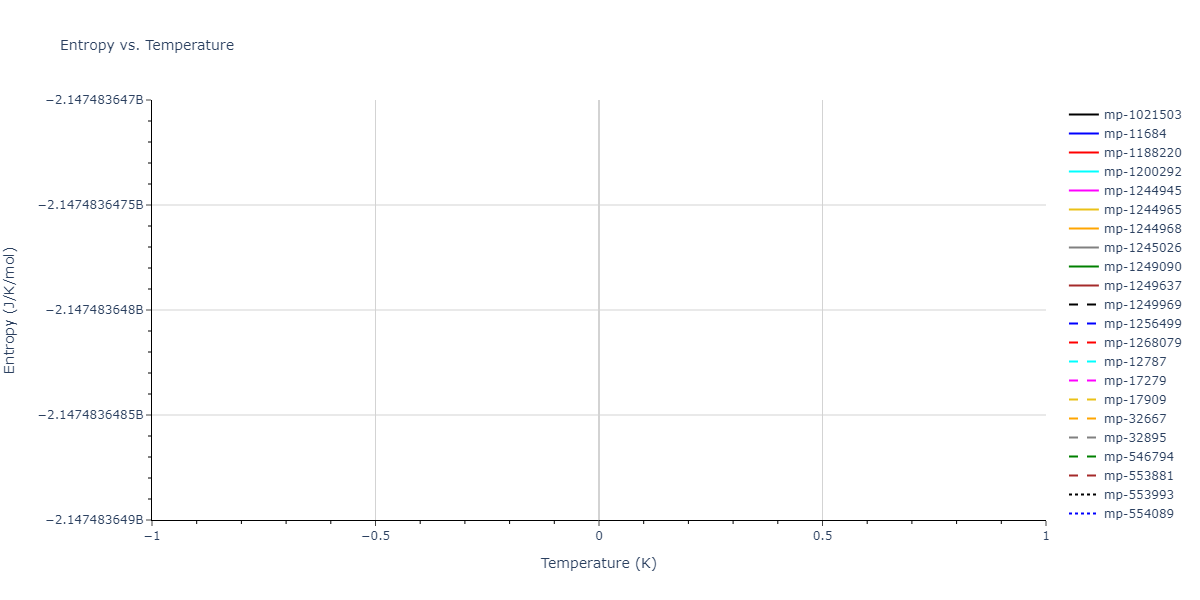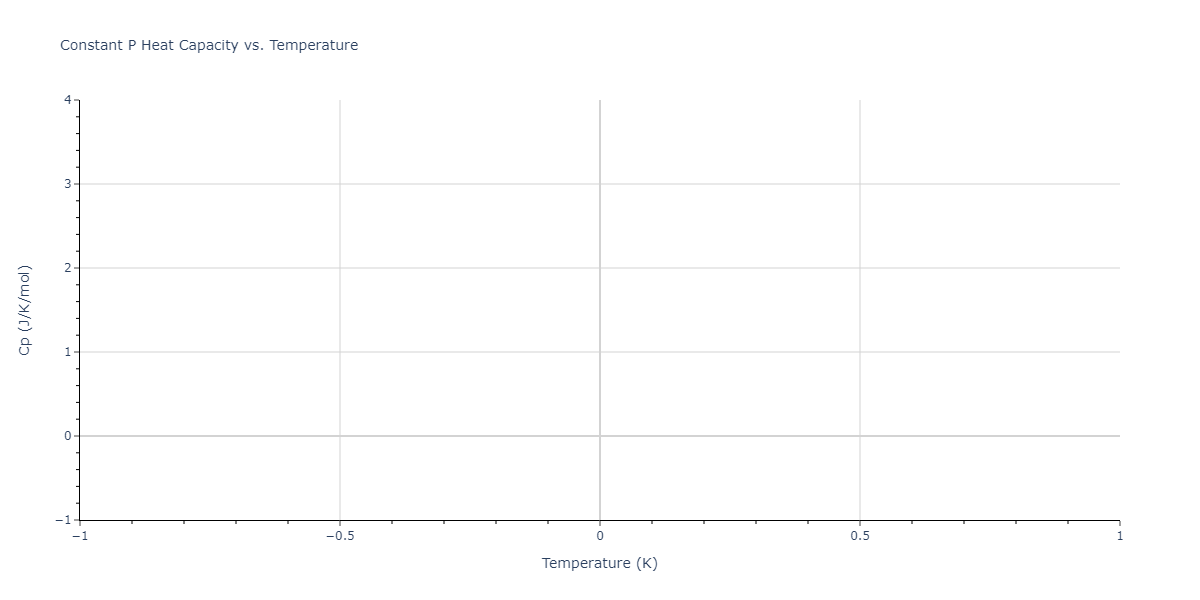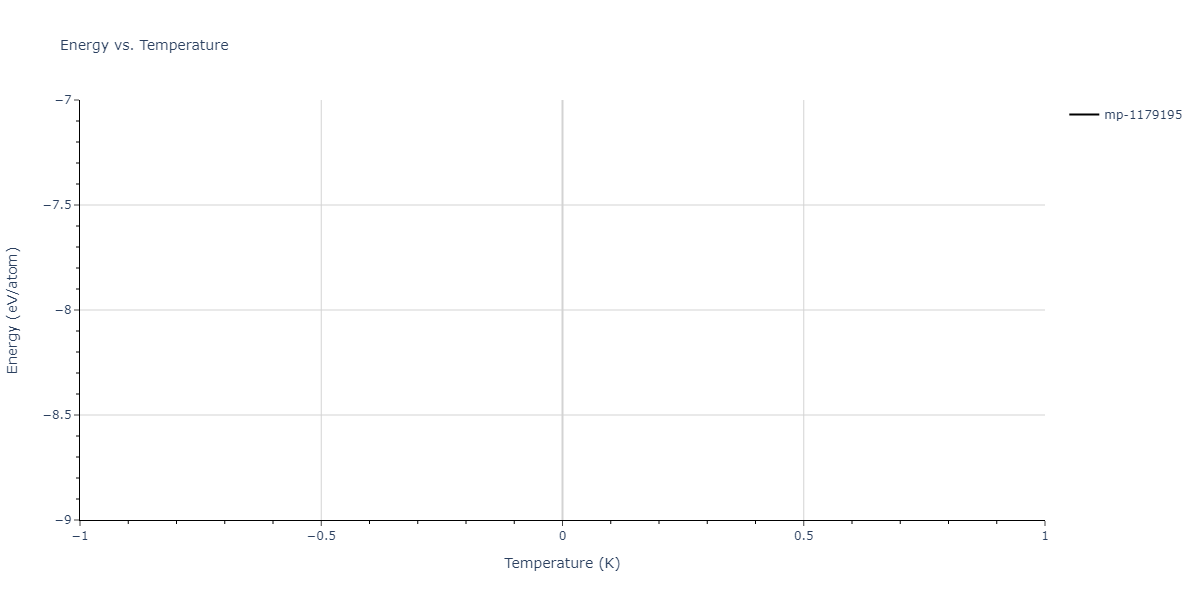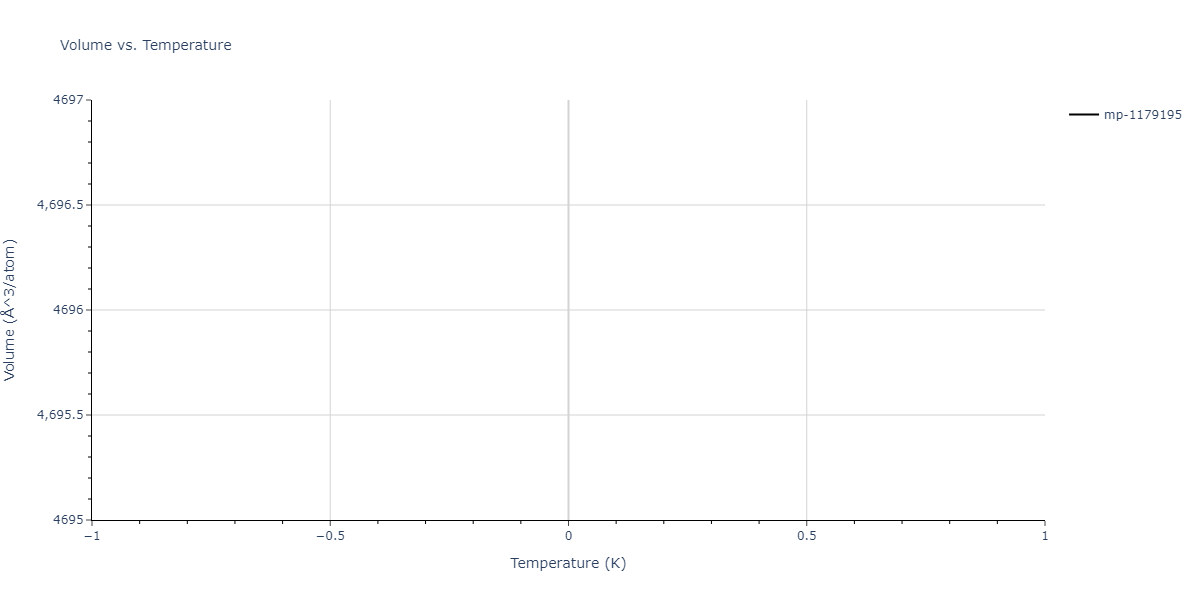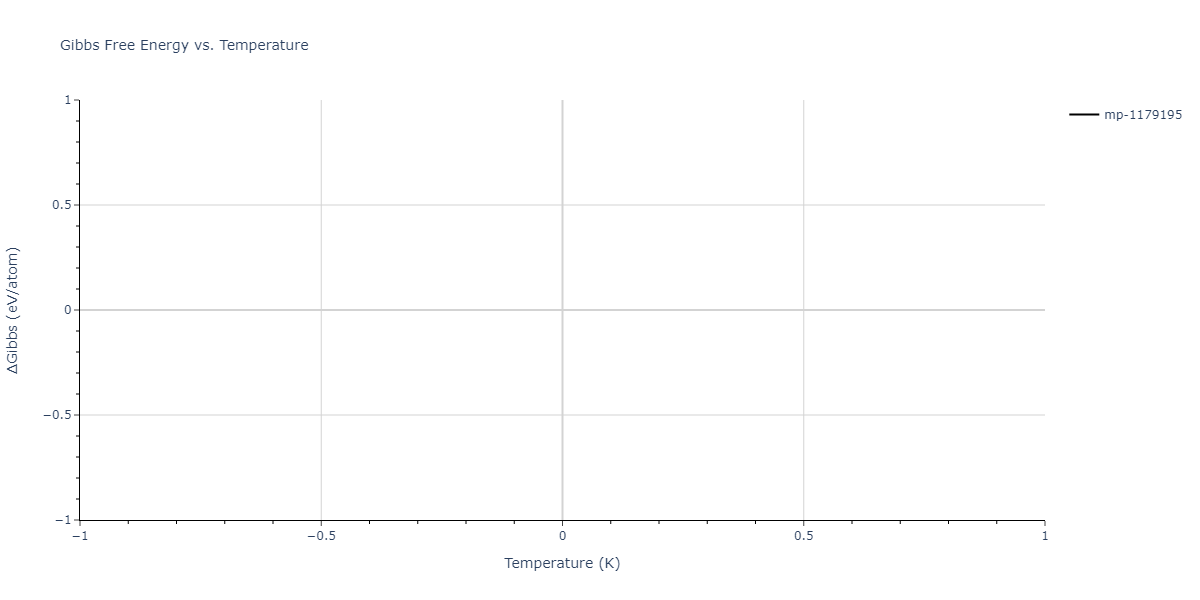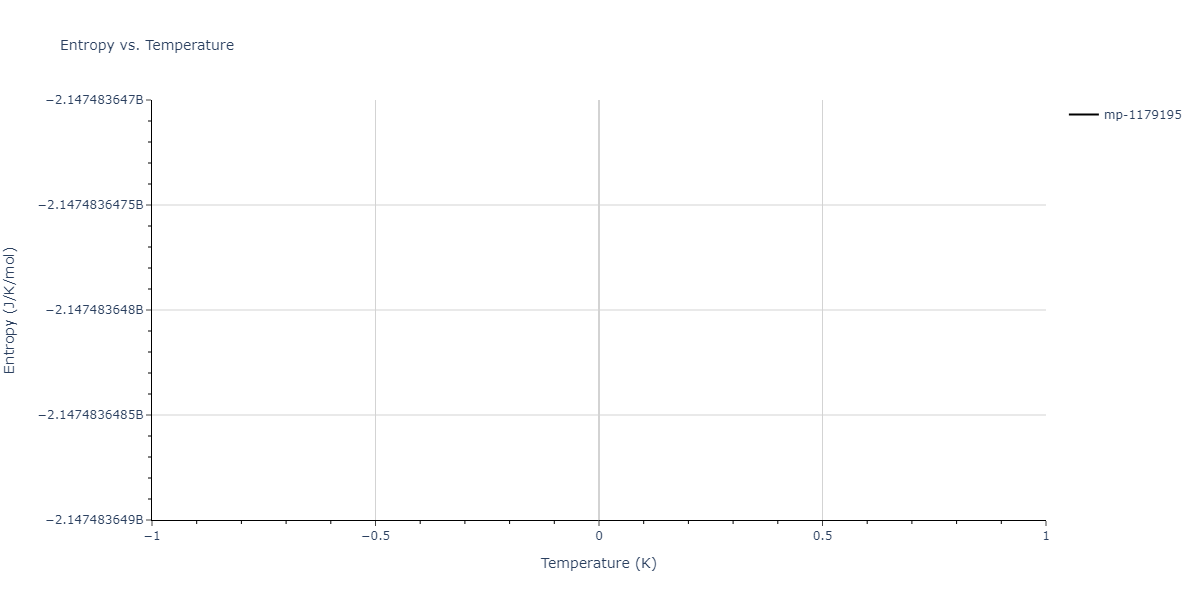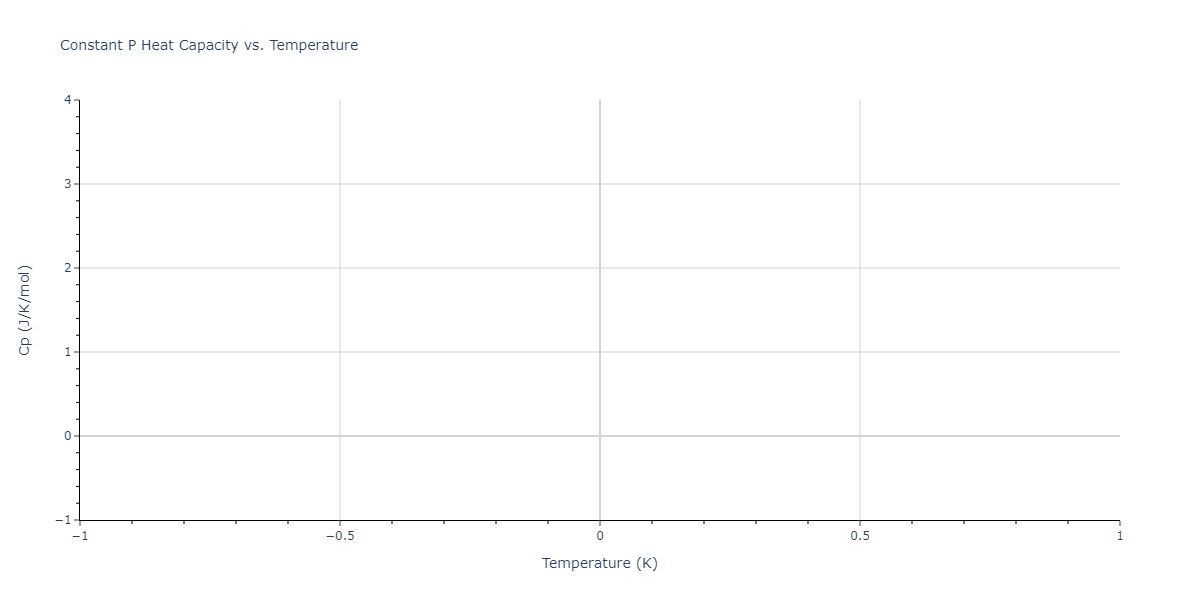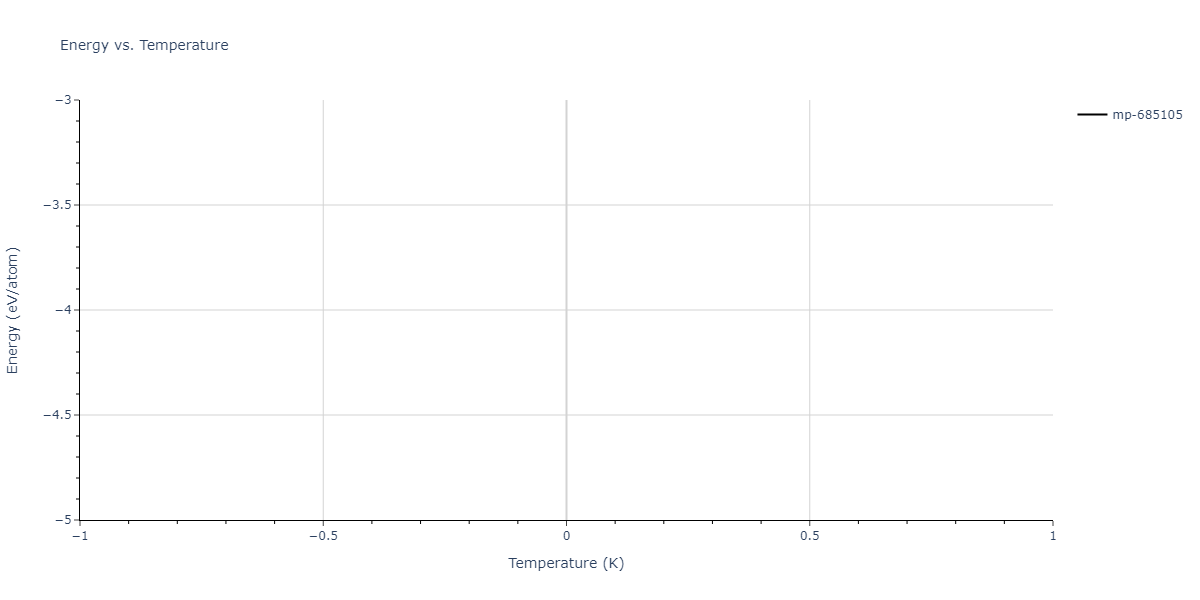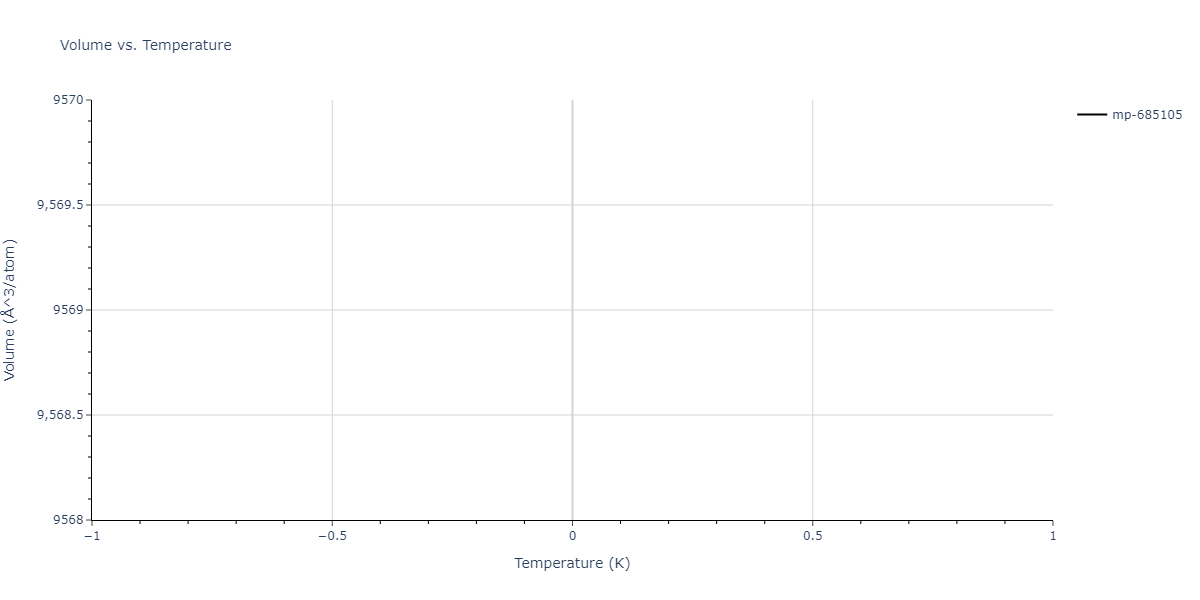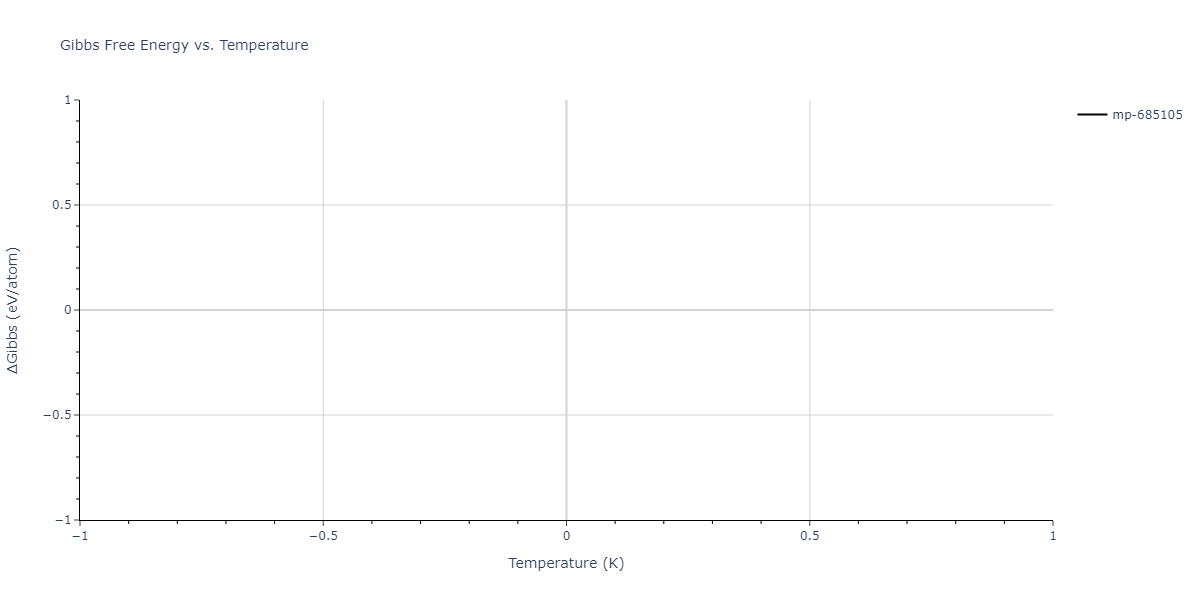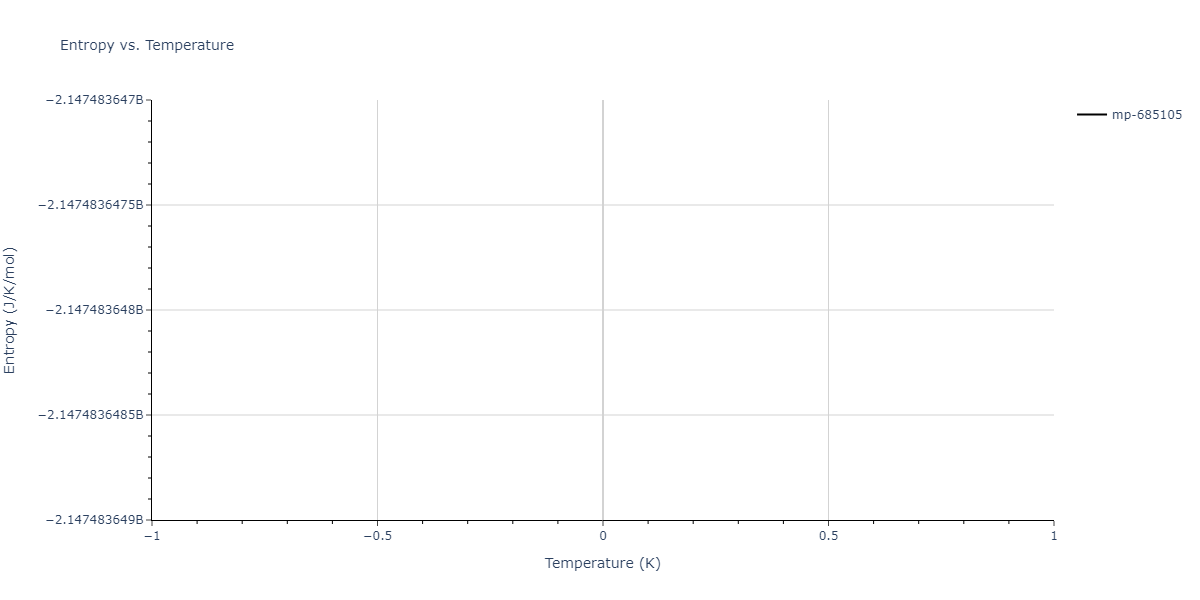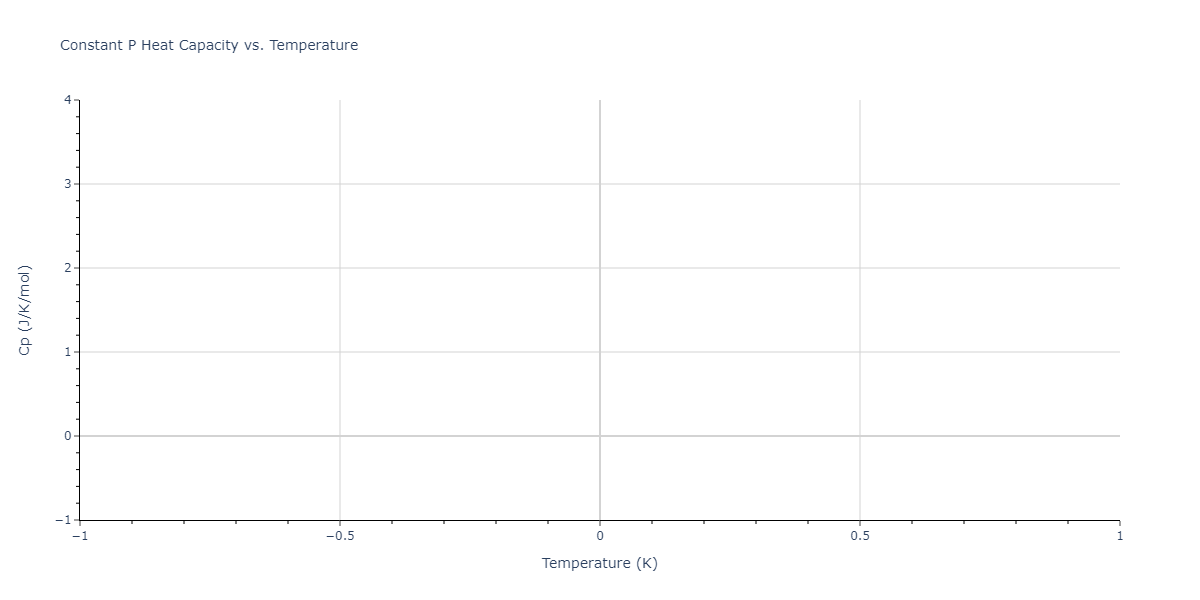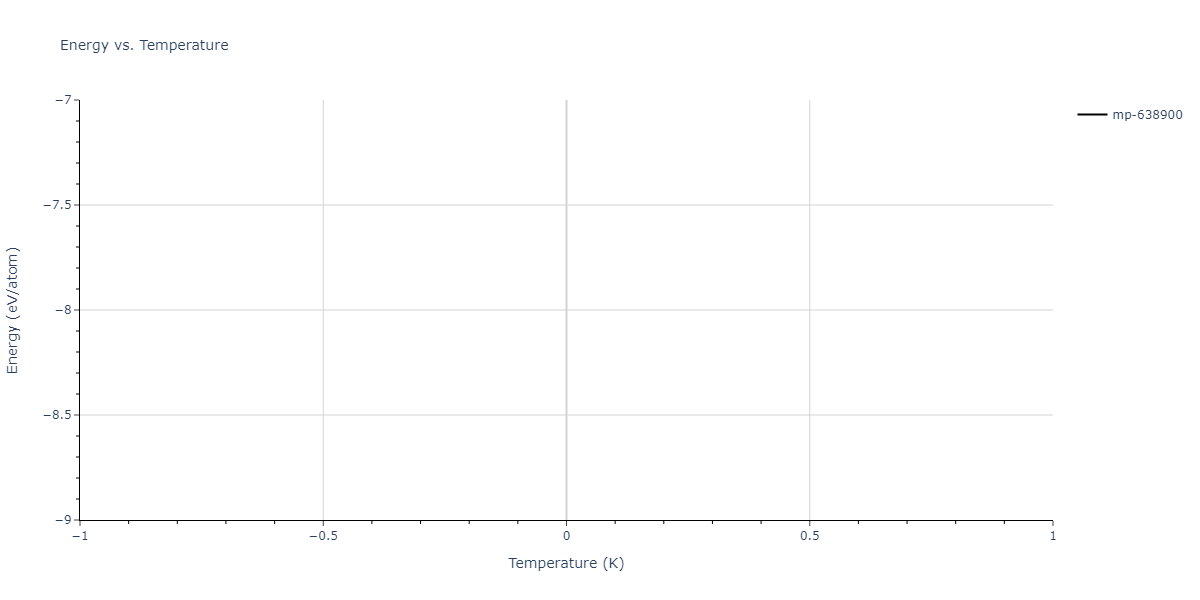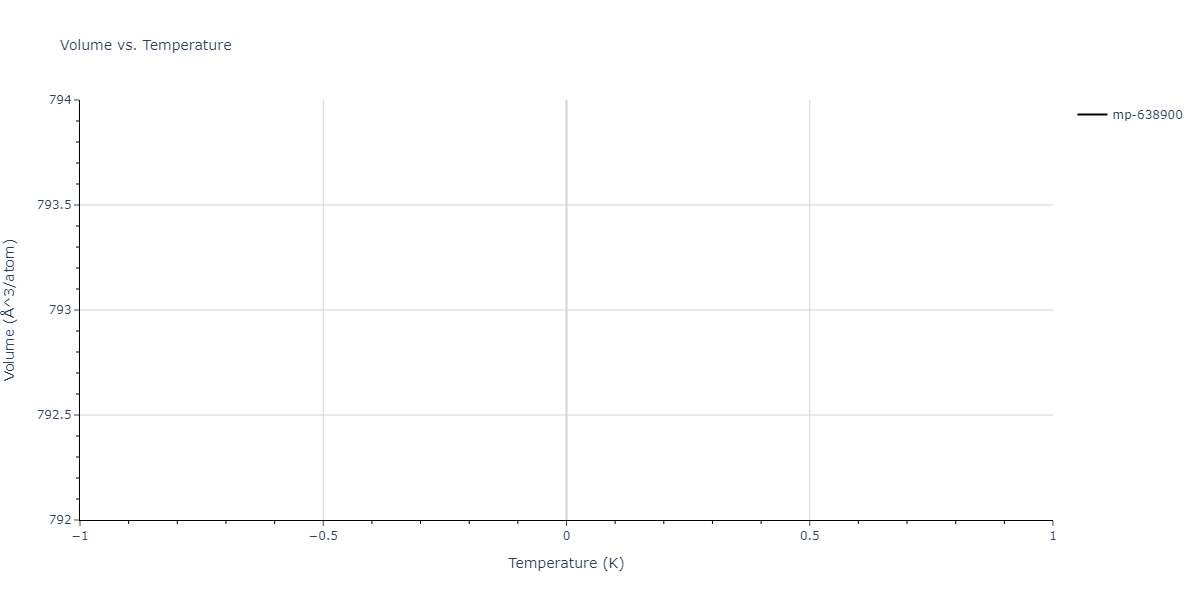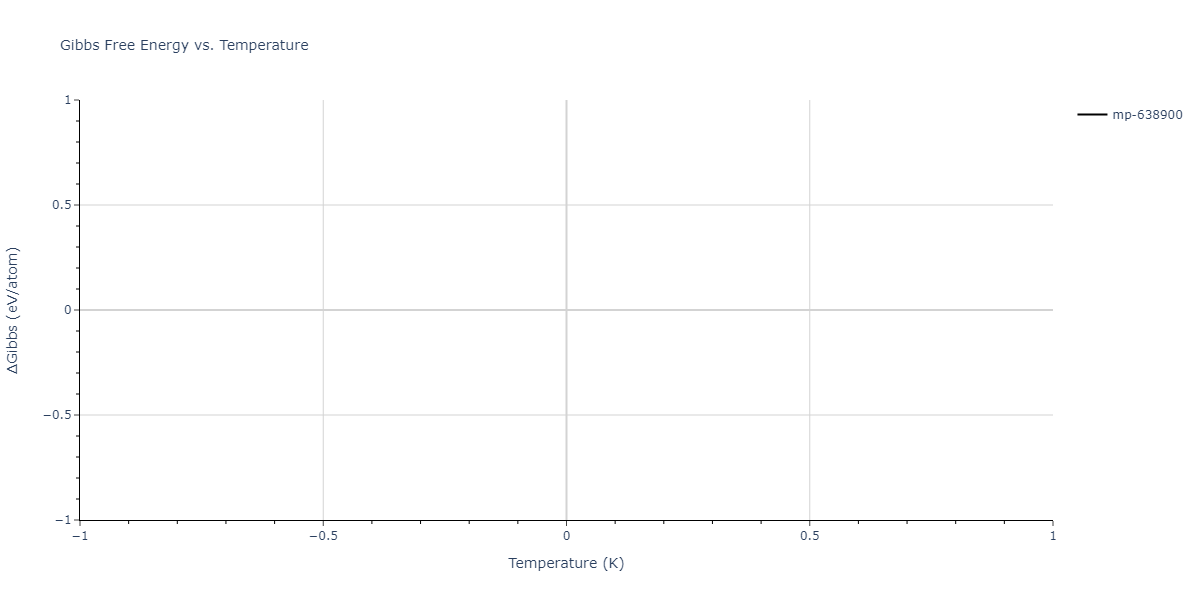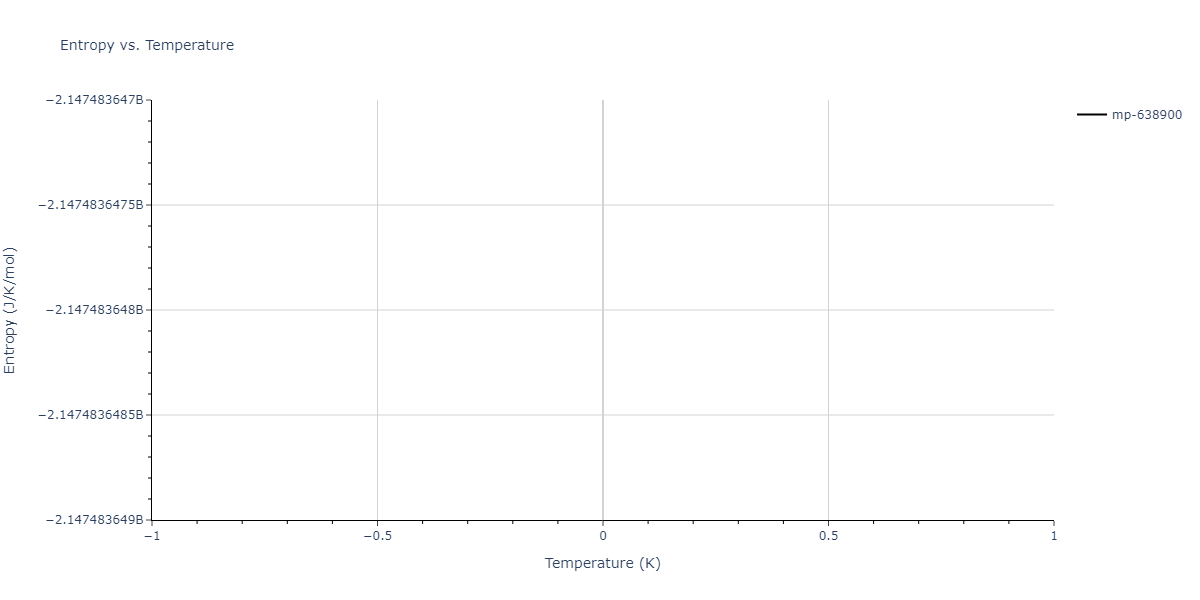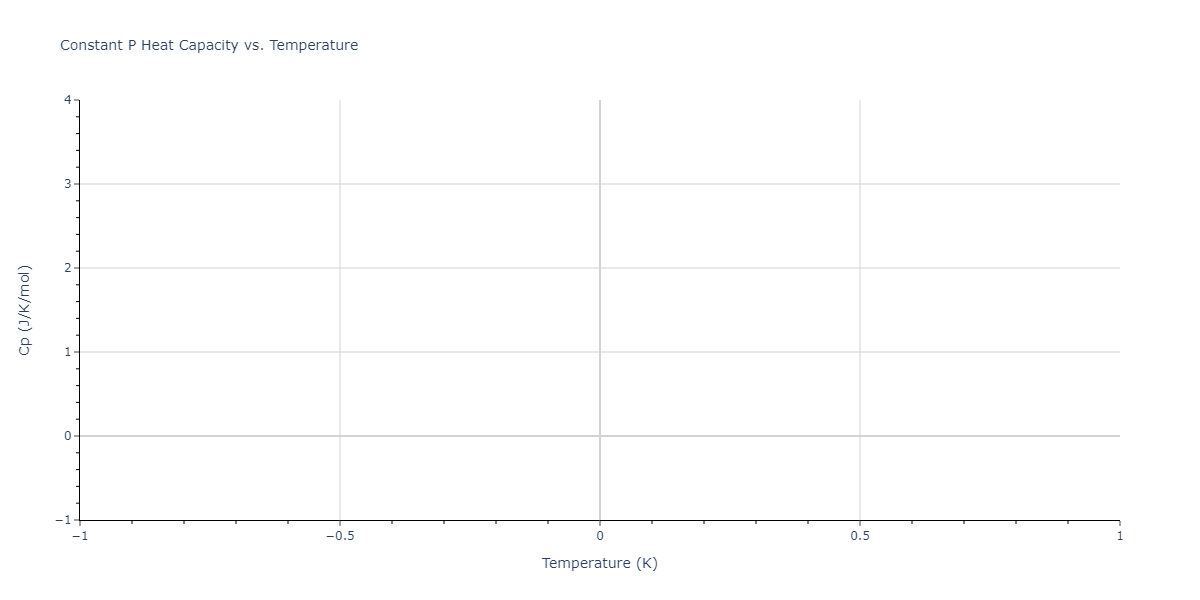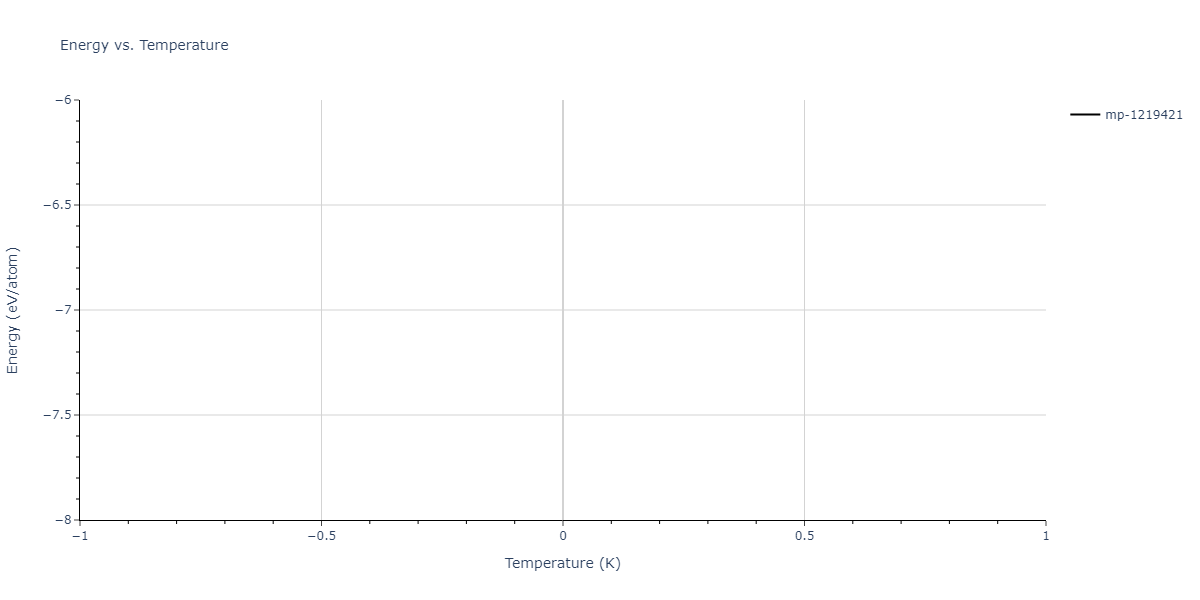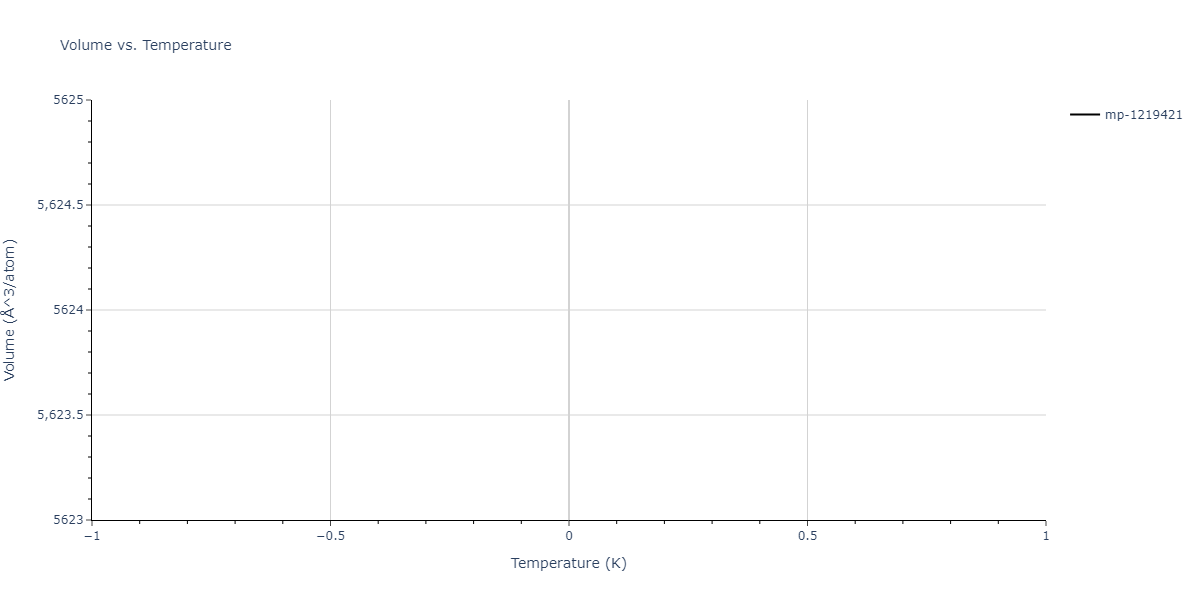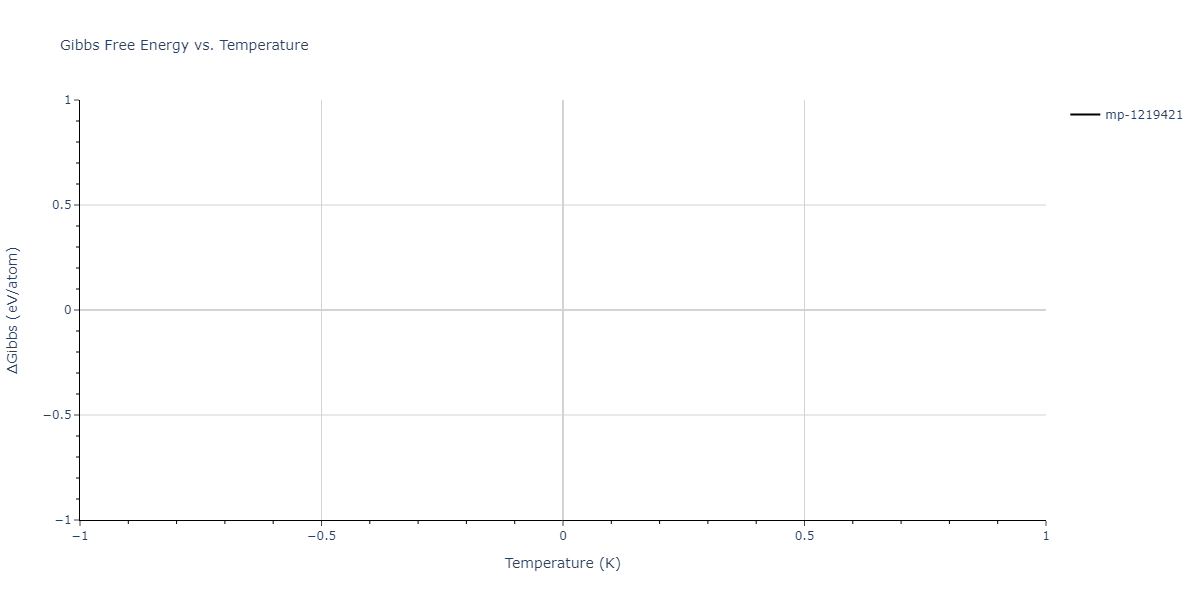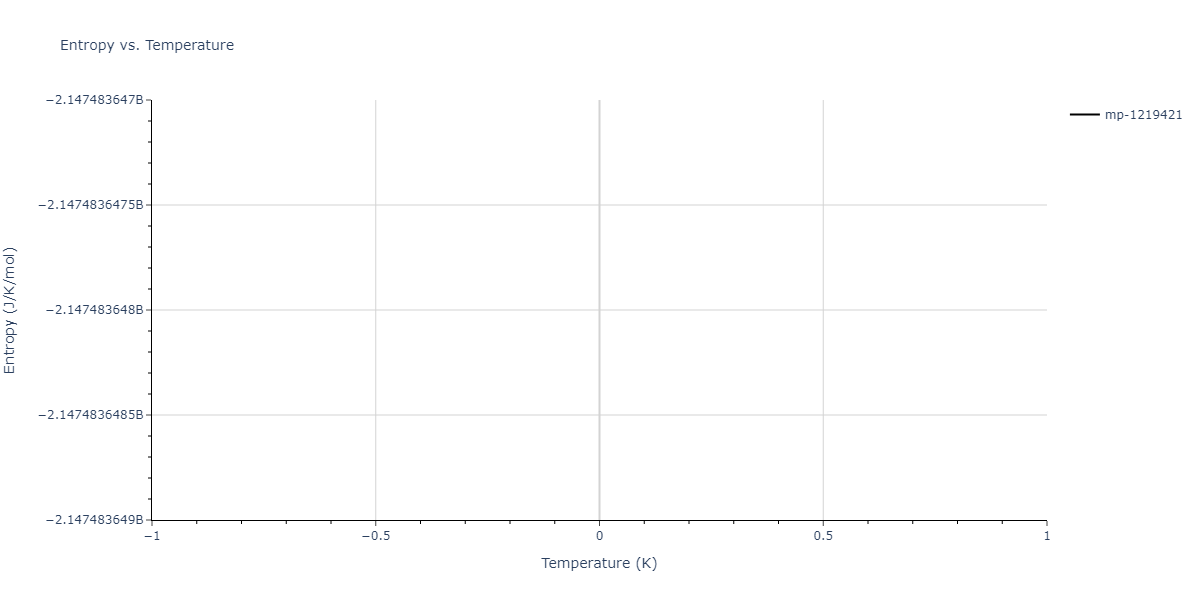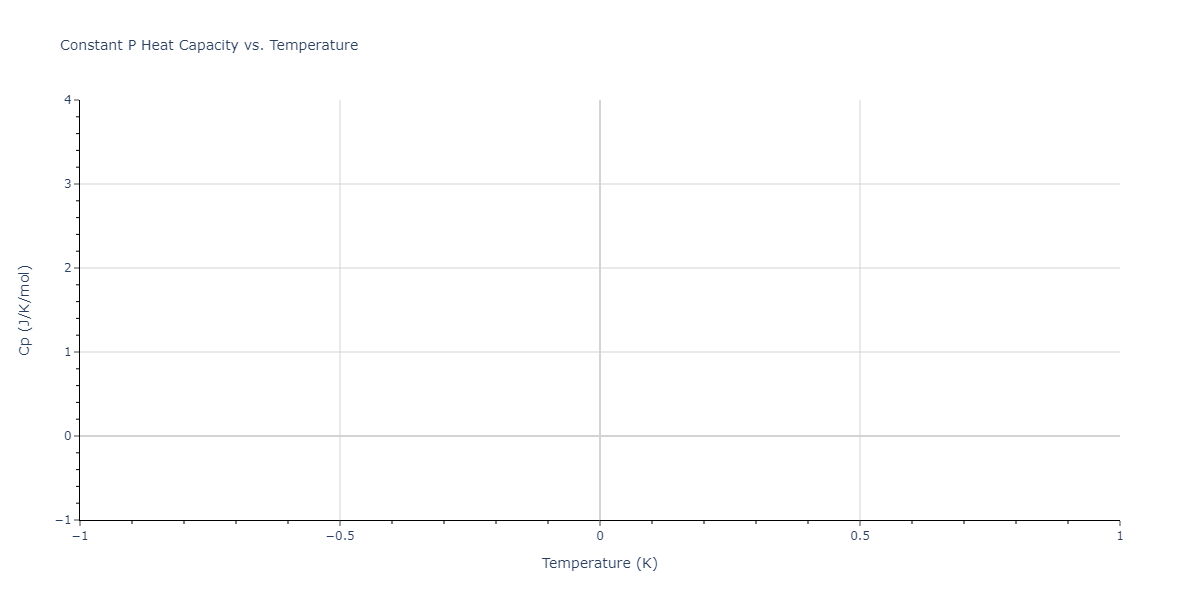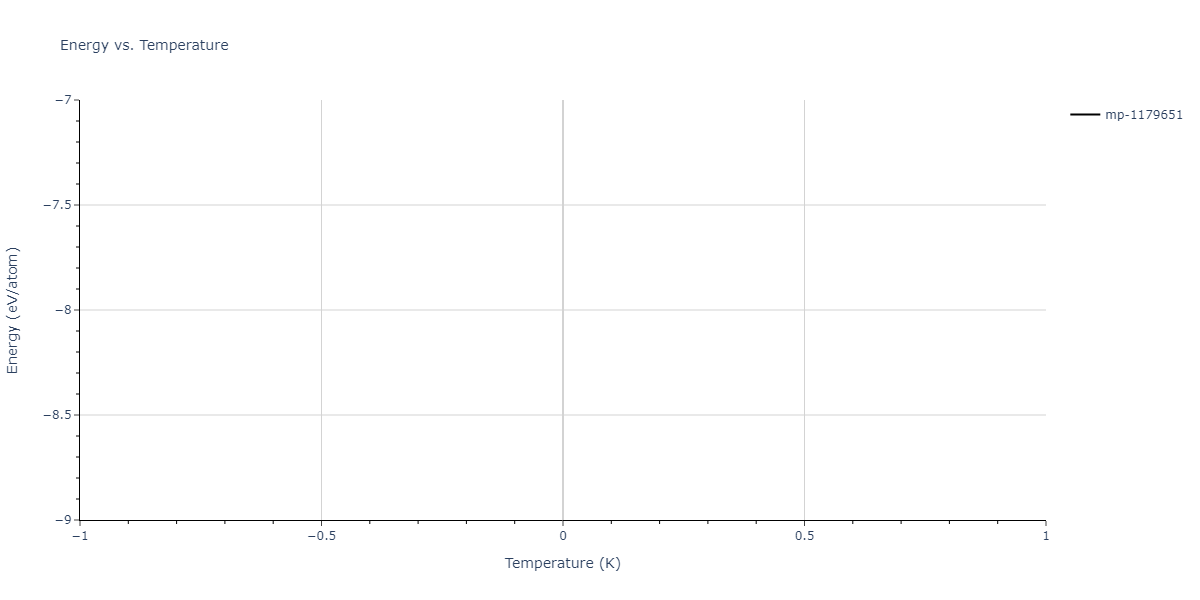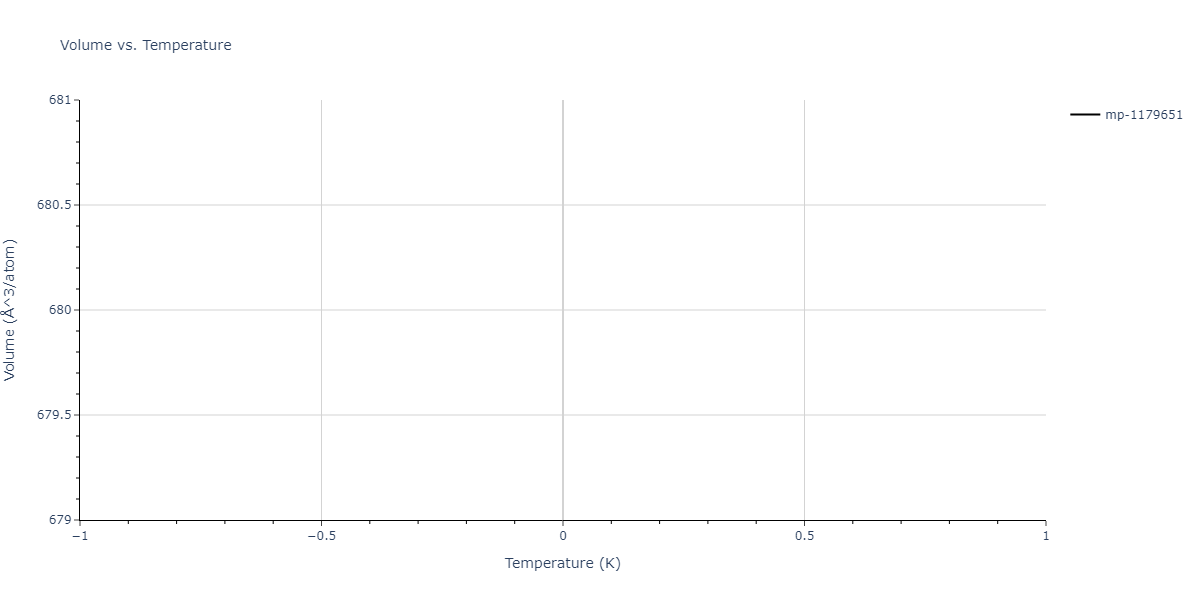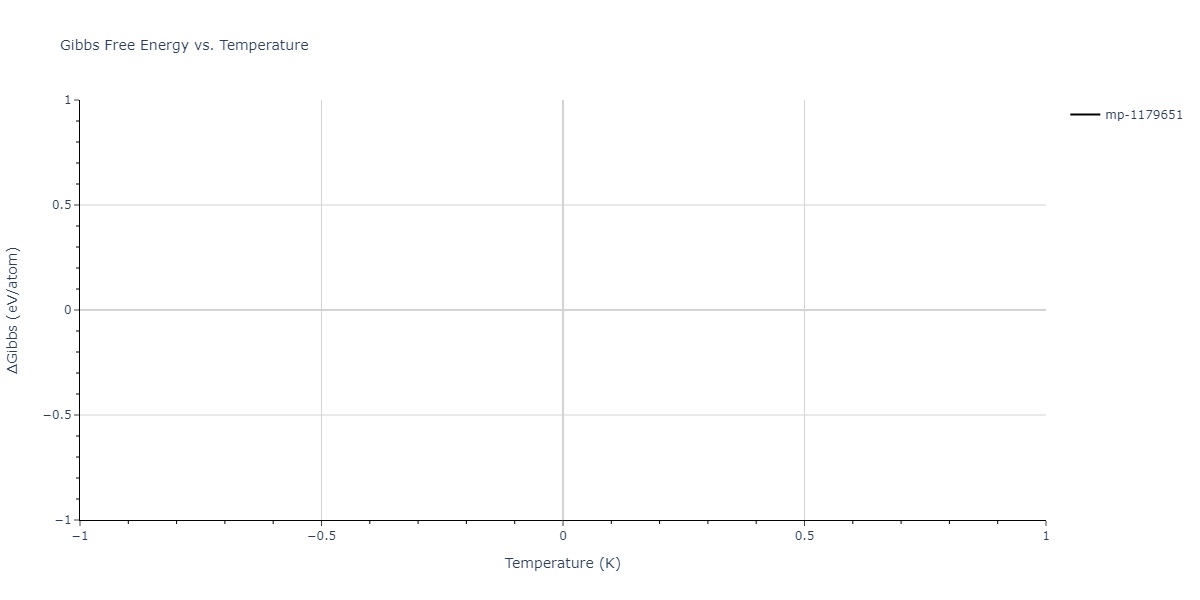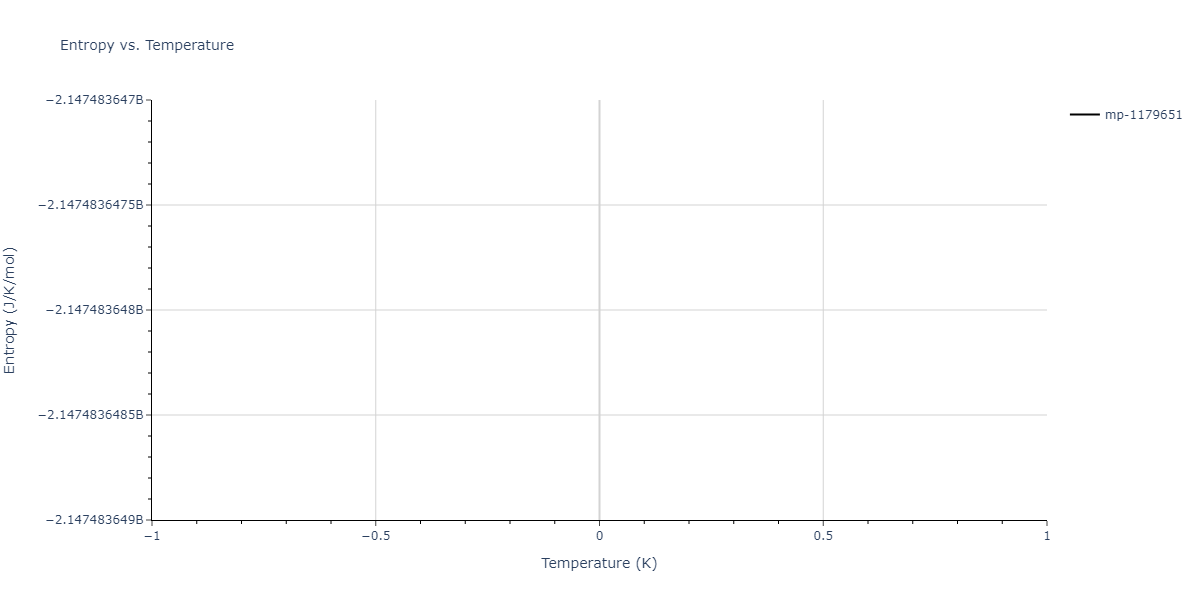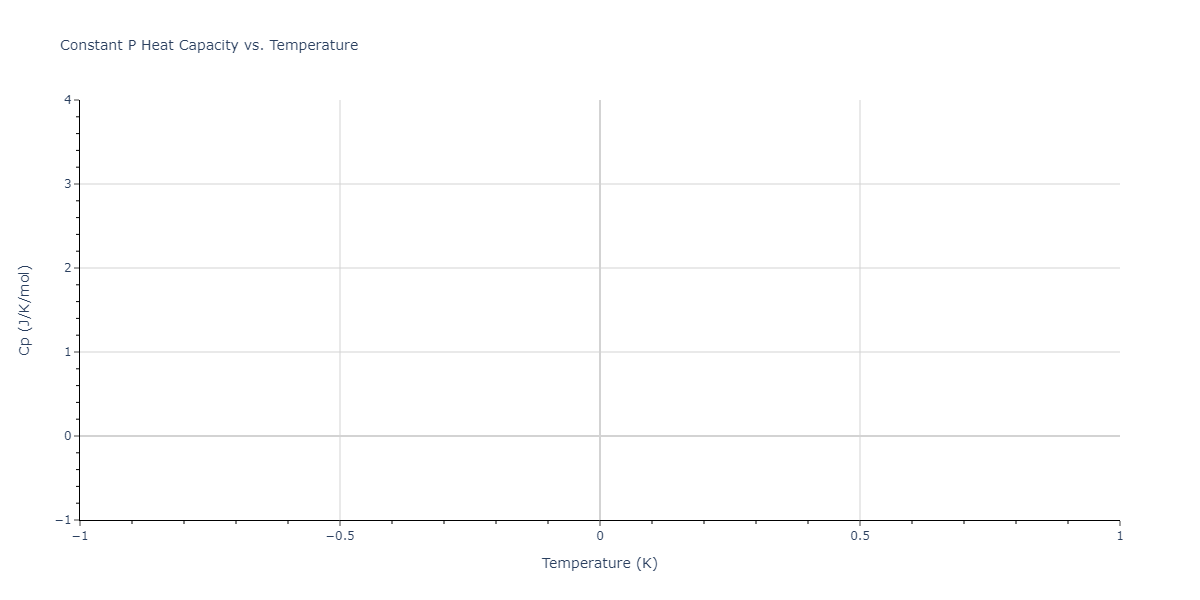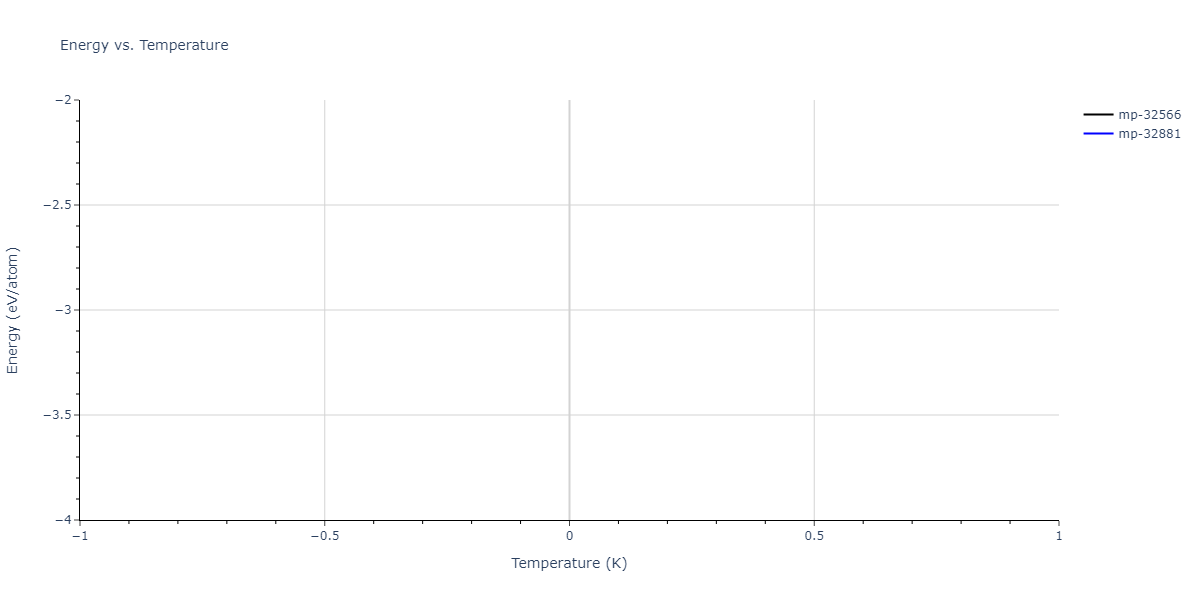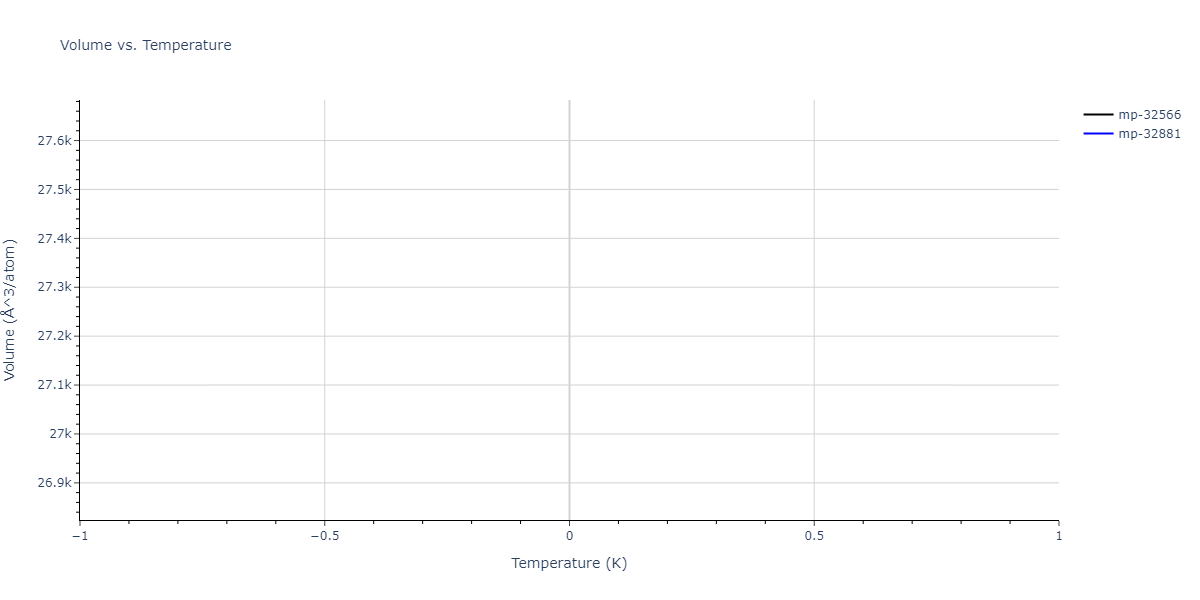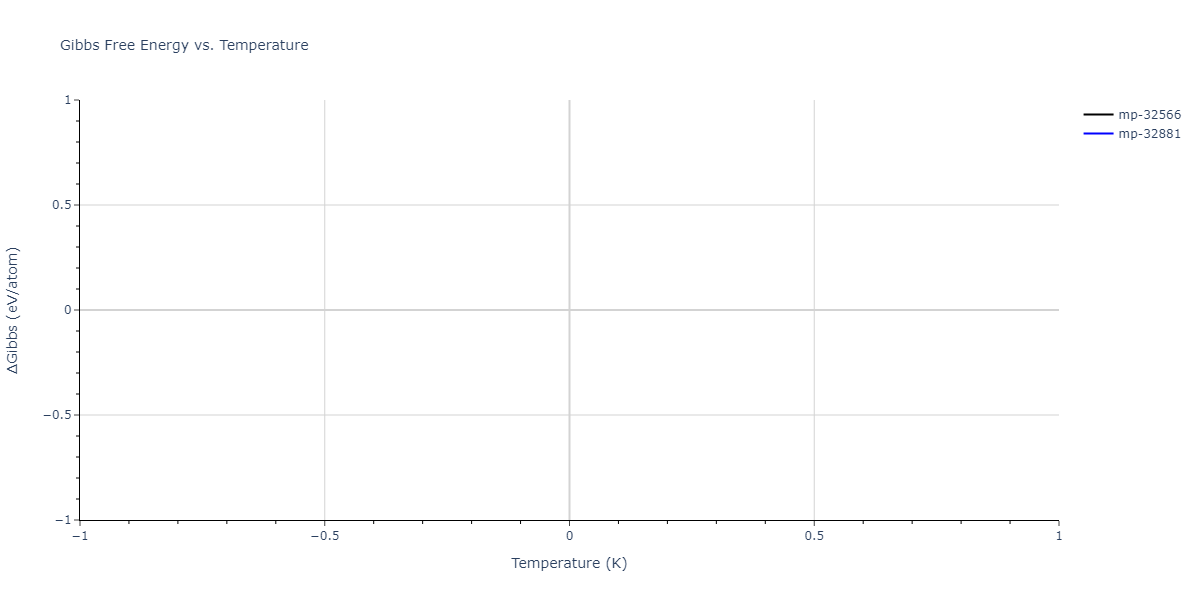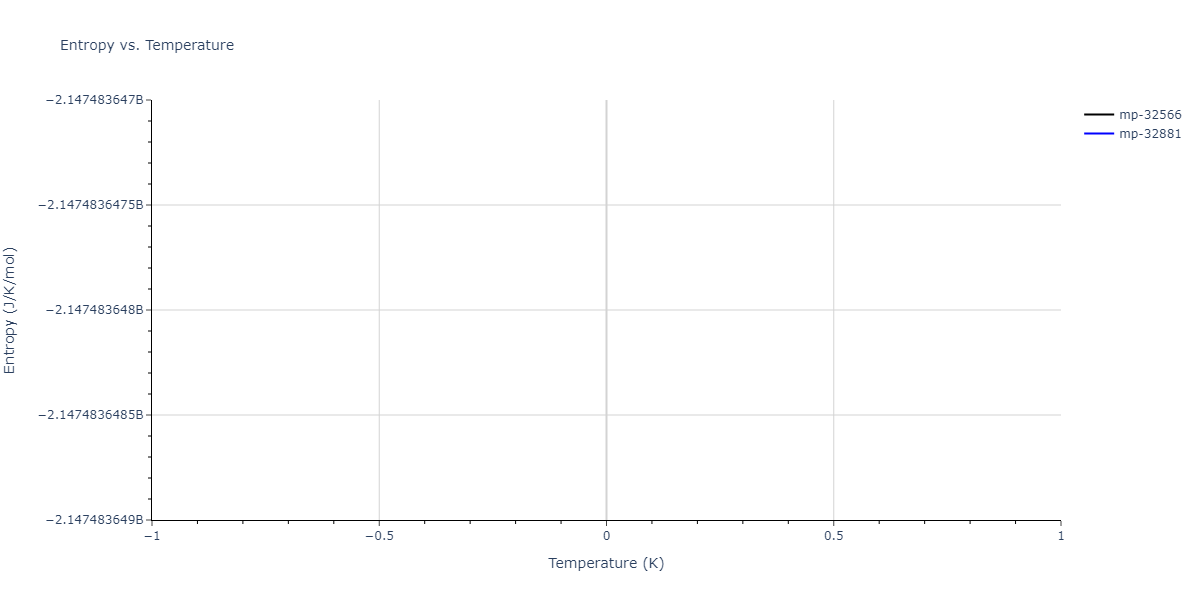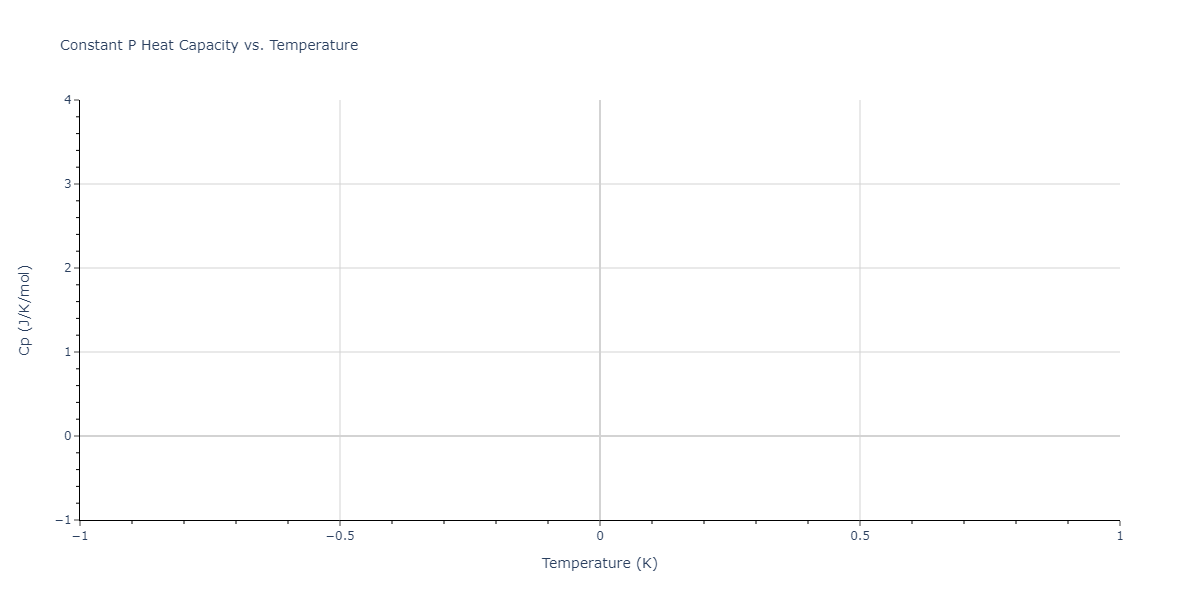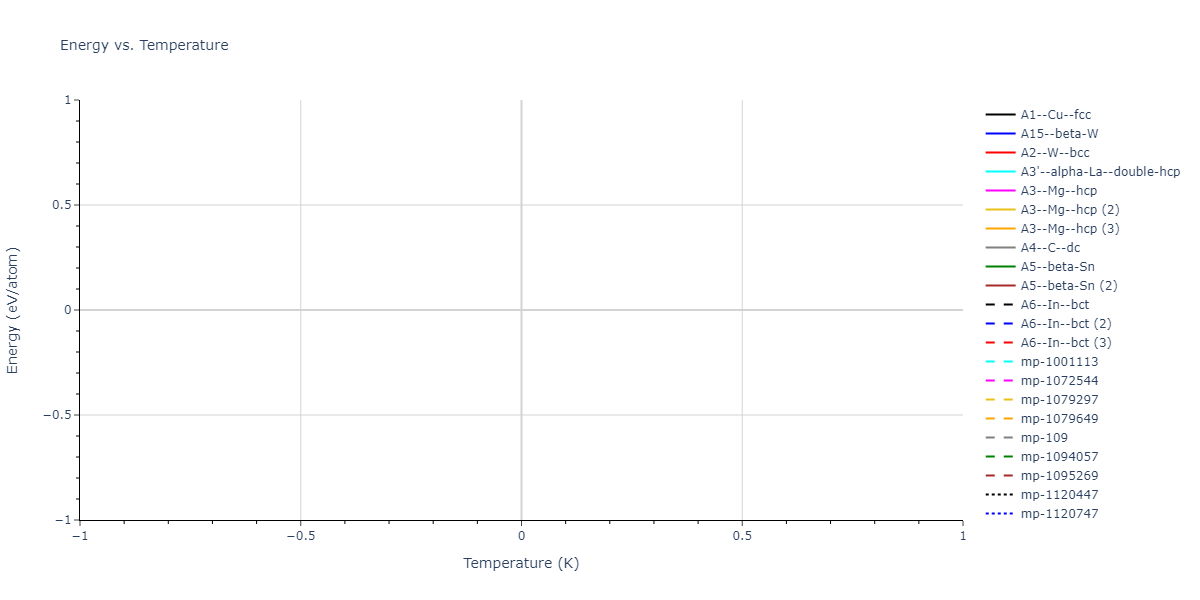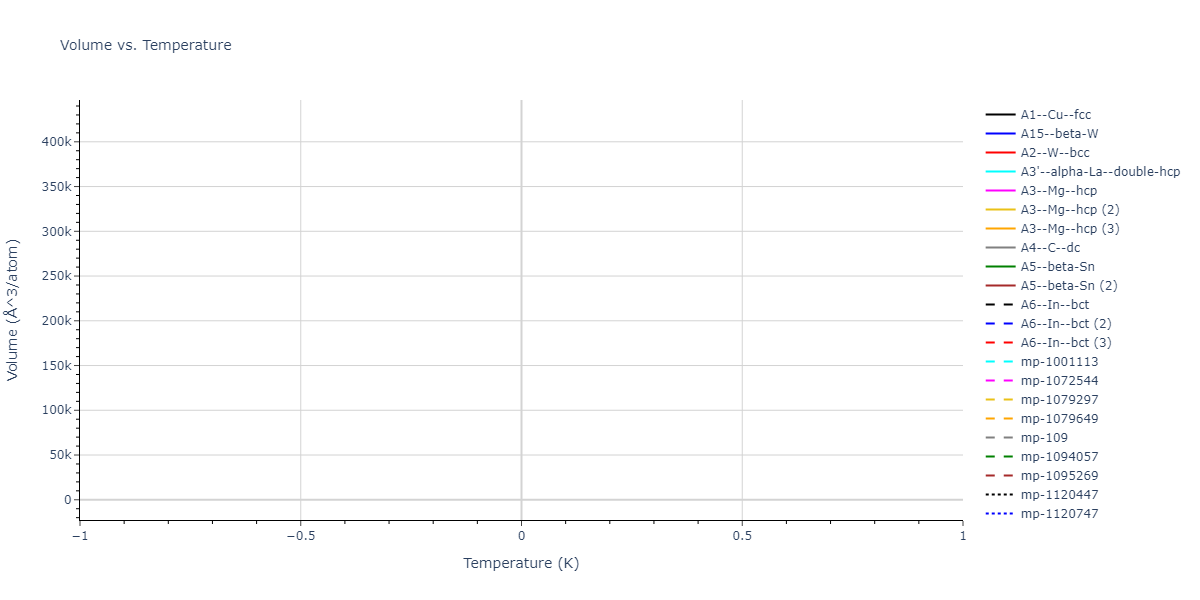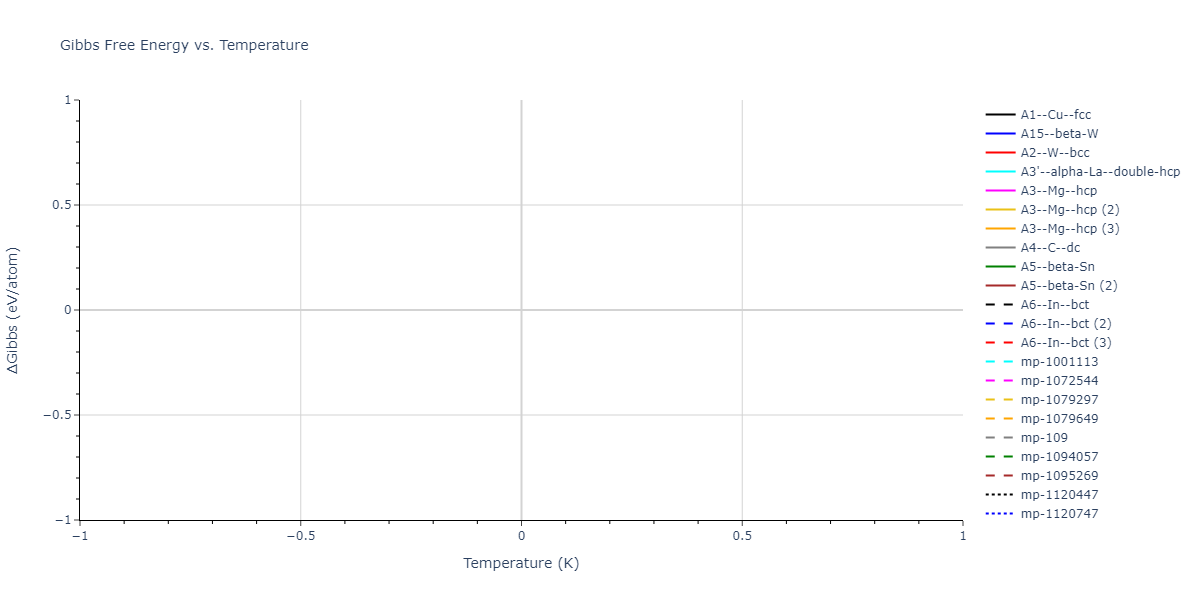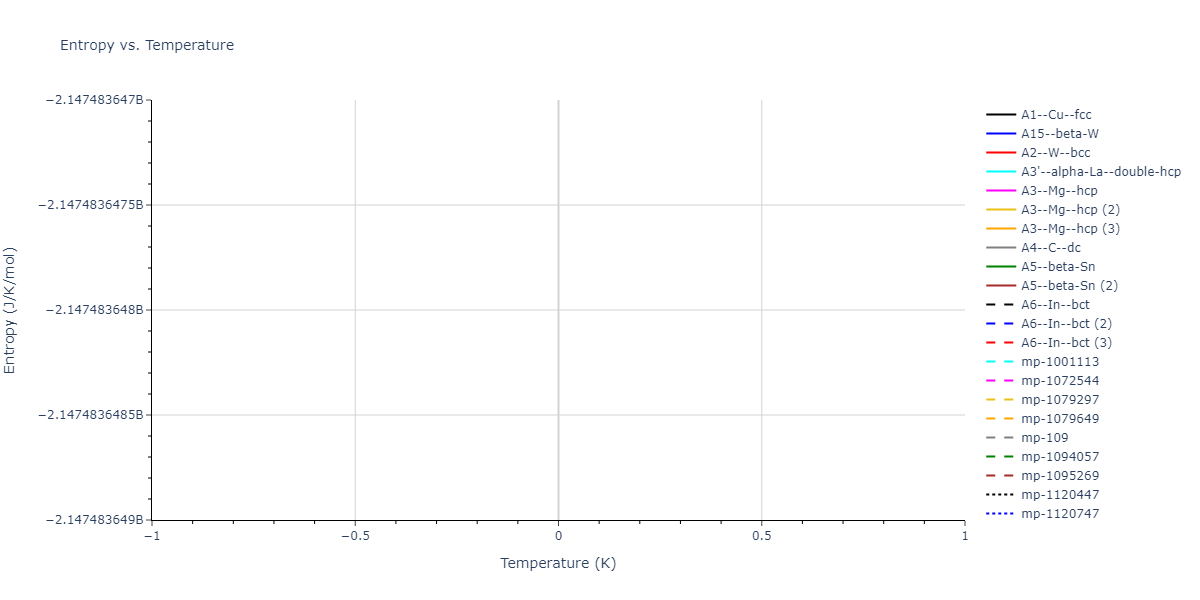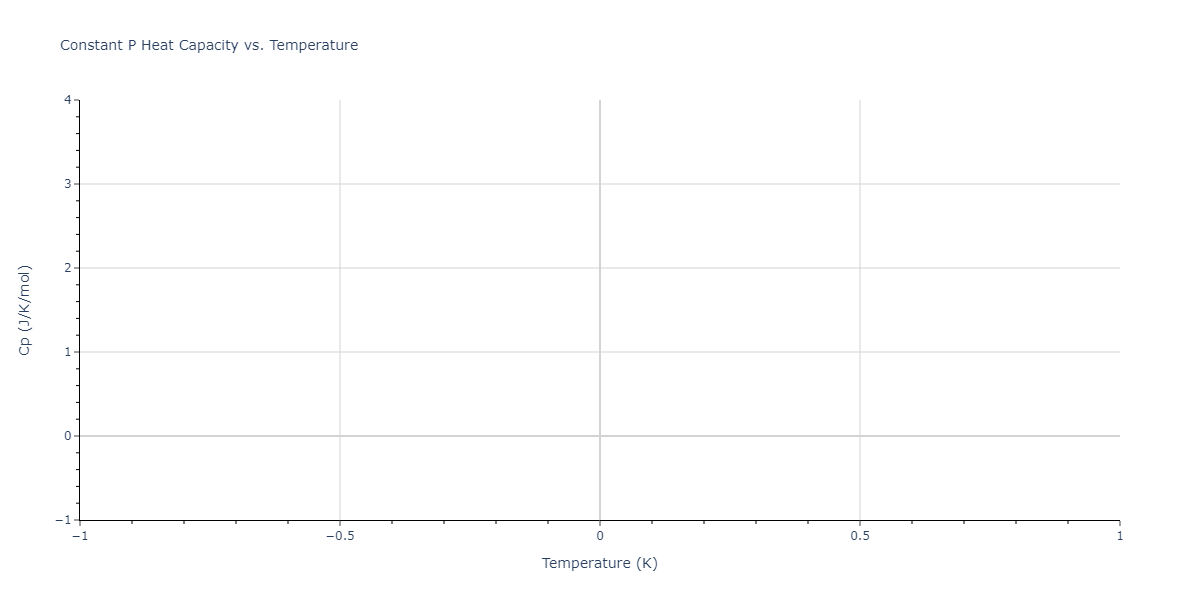-
Citation: P. Vashishta, R.K. Kalia, J.P. Rino, and I. Ebbsjö (1990), "Interaction potential for SiO2: A molecular-dynamics study of structural correlations", Physical Review B 41(17), 12197-12209. DOI: 10.1103/physrevb.41.12197.Abstract: An interaction potential consisting of two-body and three-body covalent interactions is proposed for SiO2. The interaction potential is used in molecular-dynamics studies of structural and dynamical correlations of crystalline, molten, and vitreous states under various conditions of densities and temperatures. The two-body contribution to the interaction potential consists of steric repulsion due to atomic sizes, Coulomb interactions resulting from charge transfer, and charge-dipole interaction to include the effects of large electronic polarizability of anions. The three-body covalent contributions include O-Si-O and Si-O-Si interactions which are angle dependent and functions of Si-O distance. In lattice-structure calculations with the total potential function, α-cristobalite and α-quartz are found to have the lowest and almost degenerate energies, in agreement with experiments. The energies for β-cristobalite, β-quartz, and keatite are found to be higher than those for α-cristobalite and α-quartz. Molecular-dynamics calculations with this potential function correctly describe the short- and intermediate-range order in molten and vitreous states.\nIn the latter, partial pair-distribution functions give Si-O, O-O, and Si-Si bond lengths of 1.62, 2.65, and 3.05 Å, respectively. The vitreous state consists of nearly ideal Si(O1/2)4 tetrahedra in corner-sharing configurations. The Si-O-Si bond-angle distribution has a peak at 142° and a full width at half maximum (FWHM) of 25° in good agreement with nuclear magnetic resonance experiments. The calculated static structure factor is also in agreement with neutron-diffraction experiments. Partial static structure factors reveal that intermediate-range Si-Si, O-O, and Si-O correlations between 4 and 8 Å give rise to the first sharp diffraction peak (FSDP). The FSDP is absent in charge-charge structure factor, which indicates that charge neutrality prevails over length scales between 4 and 8 Å. Dynamical correlations in vitreous and molten states, phonon densities of states of crystalline and vitreous SiO2, infrared spectra of crystalline, vitreous and molten states, isotope effect, distribution of rings and their structure in molten and vitreous states, and structural transformations at high pressures will be discussed in subsequent papers.
Related Models: -
LAMMPS pair_style vashishta (1990--Vashishta-P--Si-O--LAMMPS--ipr1)See Computed Properties
Notes: This file was taken from the August 22, 2018 LAMMPS distribution.
File(s):
Implementation Information
Diatom Energy vs. Interatomic Spacing
Plots of the potential energy vs interatomic spacing, r, are shown below for all diatom sets associated with the interatomic potential. This calculation provides insights into the functional form of the potential's two-body interactions. A system consisting of only two atoms is created, and the potential energy is evaluated for the atoms separated by 0.02 Å <= r <= 6.0> Å in intervals of 0.02 Å. Two plots are shown: one for the "standard" interaction distance range, and one for small values of r. The small r plot is useful for determining whether the potential is suitable for radiation studies.
The calculation method used is available as the iprPy diatom_scan calculation method.
Clicking on the image of a plot will open an interactive version of it in a new tab. The underlying data for the plots can be downloaded by clicking on the links above each plot.
Notes and Disclaimers:
- These values are meant to be guidelines for comparing potentials, not the absolute values for any potential's properties. Values listed here may change if the calculation methods are updated due to improvements/corrections. Variations in the values may occur for variations in calculation methods, simulation software and implementations of the interatomic potentials.
- As this calculation only involves two atoms, it neglects any multi-body interactions that may be important in molecules, liquids and crystals.
- NIST disclaimer
Version Information:
- 2019-11-14. Maximum value range on the shortrange plots are now limited to "expected" levels as details are otherwise lost.
- 2019-08-07. Plots added.
Cohesive Energy vs. Interatomic Spacing
Plots of potential energy vs interatomic spacing, r, are shown below for a number of crystal structures. The structures are generated based on the ideal atomic positions and b/a and c/a lattice parameter ratios for a given crystal prototype. The size of the system is then uniformly scaled, and the energy calculated without relaxing the system. To obtain these plots, values of r are evaluated every 0.02 Å up to 6 Å.
The calculation method used is available as the iprPy E_vs_r_scan calculation method.
Clicking on the image of a plot will open an interactive version of it in a new tab. The underlying data for the plots can be downloaded by clicking on the links above each plot.
Notes and Disclaimers:
- These values are meant to be guidelines for comparing potentials, not the absolute values for any potential's properties. Values listed here may change if the calculation methods are updated due to improvements/corrections. Variations in the values may occur for variations in calculation methods, simulation software and implementations of the interatomic potentials.
- The minima identified by this calculation do not guarantee that the associated crystal structures will be stable since no relaxation is performed.
- NIST disclaimer
Version Information:
- 2020-12-18. Descriptions, tables and plots updated to reflect that the energy values are the measuredper atom potential energy rather than cohesive energy as some potentials have non-zero isolated atom energies.
- 2019-02-04. Values regenerated with even r spacings of 0.02 Å, and now include values less than 2 Å when possible. Updated calculation method and parameters enhance compatibility with more potential styles.
- 2019-04-26. Results for hcp, double hcp, α-As and L10 prototypes regenerated from different unit cell representations. Only α-As results show noticable (>1e-5 eV) difference due to using a different coordinate for Wykoff site c position.
- 2018-06-13. Values for MEAM potentials corrected. Dynamic versions of the plots moved to separate pages to improve page loading. Cosmetic changes to how data is shown and updates to the documentation.
- 2017-01-11. Replaced png pictures with interactive Bokeh plots. Data regenerated with 200 values of r instead of 300.
- 2016-09-28. Plots for binary structures added. Data and plots for elemental structures regenerated. Data values match the values of the previous version. Data table formatting slightly changed to increase precision and ensure spaces between large values. Composition added to plot title and structure names made longer.
- 2016-04-07. Plots for elemental structures added.
Crystal Structure Predictions
Computed lattice constants and cohesive/potential energies are displayed for a variety of crystal structures. The values displayed here are obtained using the following process.
- Initial crystal structure guesses are taken from:
- The iprPy E_vs_r_scan calculation results (shown above) by identifying all energy minima along the measured curves for a given crystal prototype + composition.
- Structures in the Materials Project and OQMD DFT databases.
- All initial guesses are relaxed using three independent methods using a 10x10x10 supercell:
- "box": The system's lattice constants are adjusted to zero pressure without internal relaxations using the iprPy relax_box calculation with a strainrange of 1e-6.
- "static": The system's lattice and atomic positions are statically relaxed using the iprPy relax_static calculation with a minimization force tolerance of 1e-10 eV/Angstrom.
- "dynamic": The system's lattice and atomic positions are dynamically relaxed for 10000 timesteps of 0.01 ps using the iprPy relax_dynamic calculation with an nph integration plus Langevin thermostat. The final configuration is then used as input in running an iprPy relax_static calculation with a minimization force tolerance of 1e-10 eV/Angstrom.
- The relaxed structures obtained from #2 are then evaluated using the spglib package to identify an ideal crystal unit cell based on the results.
- The space group information of the ideal unit cells is compared to the space group information of the corresponding reference structures to identify which structures transformed upon relaxation. The structures that did not transform to a different structure are listed in the table(s) below. The "method" field indicates the most rigorous relaxation method where the structure did not transform. The space group information is also used to match the DFT reference structures to the used prototype, where possible.
- The cohesive energy, Ecoh, is calculated from the measured potential energy per atom, Epot$, by subtracting the isolated energy averaged across all atoms in the unit cell. The isolated atom energies of each species model is obtained either by evaluating a single atom atomic configuration, or by identifying the first energy plateau from the diatom scan calculations for r > 2 Å.
The calculation methods used are implemented into iprPy as the following calculation styles
Notes and Disclaimers:
- These values are meant to be guidelines for comparing potentials, not the absolute values for any potential's properties. Values listed here may change if the calculation methods are updated due to improvements/corrections. Variations in the values may occur for variations in calculation methods, simulation software and implementations of the interatomic potentials.
- The presence of any structures in this list does not guarantee that those structures are stable. Also, the lowest energy structure may not be included in this list.
- Multiple values for the same crystal structure but different lattice constants are possible. This is because multiple energy minima are possible for a given structure and interatomic potential. Having multiple energy minima for a structure does not necessarily make the potential "bad" as unwanted configurations may be unstable or correspond to conditions that may not be relevant to the problem of interest (eg. very high strains).
- NIST disclaimer
Version Information:
- 2025-07-02. All "mp-" reference structure calculations were re-relaxed using the updated Materials Project database rather than the original database structures. Also, a bug was fixed that caused the "static" relaxations to occasionally throw unnecessary errors. This was fixed and all affected calculations were reset and performed again.
- 2022-05-27. The "box" method results have all been redone with an updated methodology more suited for non-orthogonal systems.
- 2020-12-18. Cohesive energies have been corrected by making them relative to the energies of the isolated atoms. The previous cohesive energy values are now listed as the potential energies.
- 2019-06-07. Structures with positive or near zero cohesive energies removed from the display tables. All values still present in the raw data files.
- 2019-04-26. Calculations now computed for each implementation. Results for hcp, double hcp, α-As and L10 prototypes regenerated from different unit cell representations.
- 2018-06-14. Methodology completely changed affecting how the information is displayed. Calculations involving MEAM potentials corrected.
- 2016-09-28. Values for simple compounds added. All identified energy minima for each structure are listed. The existing elemental data was regenerated. Most values are consistent with before, but some differences have been noted. Specifically, variations are seen with some values for potentials where the elastic constants don't vary smoothly near the equilibrium state. Additionally, the inclusion of some high-energy structures has changed based on new criteria for identifying when structures have relaxed to another structure.
- 2016-04-07. Values for elemental crystal structures added. Only values for the global energy minimum of each unique structure given.
Download raw data (including filtered results)
Reference structure matches:
A1--Cu--fcc = oqmd-1214552
A15--beta-W = oqmd-1214997
A2--W--bcc = oqmd-1215175
A3'--alpha-La--double-hcp = oqmd-1215443
A3--Mg--hcp = oqmd-1215353
A4--C--dc = mp-1057818, oqmd-1215532
A5--beta-Sn = oqmd-1215621
A6--In--bct = oqmd-1215710
A7--alpha-As = mp-610917, oqmd-8088, oqmd-36776, oqmd-114513, oqmd-1215799
| prototype | method | Ecoh (eV/atom) | Epot (eV/atom) | a0 (Å) | b0 (Å) | c0 (Å) | α (degrees) | β (degrees) | γ (degrees) |
|---|---|---|---|---|---|---|---|---|---|
| oqmd-47818 | dynamic | -0.0 | -0.0 | 17.2422 | 10.1345 | 17.249 | 90.0 | 107.7 | 90.0 |
| oqmd-1215264 | dynamic | -0.0 | -0.0 | 10.185 | 25.0488 | 13.6742 | 90.0 | 90.0 | 90.0 |
| A1--Cu--fcc | dynamic | -0.0 | -0.0 | 14.1421 | 14.1421 | 14.1421 | 90.0 | 90.0 | 90.0 |
| A7--alpha-As | dynamic | -0.0 | -0.0 | 10.0 | 10.0 | 834.9243 | 90.0 | 90.0 | 120.0 |
| mp-1066100 | dynamic | -0.0 | -0.0 | 10.0 | 10.0 | 674.5676 | 90.0 | 90.0 | 120.0 |
| oqmd-6836 | static | -0.0 | -0.0 | 10.641 | 16.9343 | 57.1547 | 90.0 | 90.0 | 90.0 |
| mp-607540 | dynamic | -0.0 | -0.0 | 10.8853 | 16.7783 | 545.2108 | 90.0 | 90.0 | 90.0 |
| A4--C--dc | dynamic | -0.0 | -0.0 | 23.094 | 23.094 | 23.094 | 90.0 | 90.0 | 90.0 |
| A7--alpha-As | dynamic | -0.0 | -0.0 | 10.0011 | 10.0011 | 54.4935 | 90.0 | 90.0 | 120.0 |
| mp-1180064 | dynamic | -0.0 | -0.0 | 10.0 | 65.8687 | 69.3978 | 88.0 | 88.5 | 87.6 |
| mp-607540 | static | -0.0 | -0.0 | 11.2731 | 16.5202 | 63.3556 | 90.0 | 90.0 | 90.0 |
| mp-12957 | dynamic | -0.0 | -0.0 | 20.0 | 20.0 | 335.19 | 90.0 | 91.4 | 90.0 |
| mp-1180036 | dynamic | -0.0 | -0.0 | 134.2112 | 10.0 | 18.0849 | 90.0 | 90.7 | 90.0 |
| mp-1102442 | dynamic | -0.0 | -0.0 | 69.0633 | 69.0633 | 10.0 | 90.0 | 90.0 | 90.0 |
| mp-1066100 | static | -0.0 | -0.0 | 10.0 | 10.0 | 64.0037 | 90.0 | 90.0 | 120.0 |
| A6--In--bct | dynamic | -0.0 | -0.0 | 10.0 | 10.0 | 15.8324 | 90.0 | 90.0 | 90.0 |
| oqmd-16142 | dynamic | -0.0 | -0.0 | 10.0 | 16.1511 | 10.0041 | 90.0 | 106.1 | 90.0 |
| mp-611836 | static | -0.0 | -0.0 | 20.6627 | 10.0 | 30.3366 | 90.0 | 100.3 | 90.0 |
| A7--alpha-As | dynamic | 0.0 | 0.0 | 10.0021 | 10.0021 | 54.4923 | 90.0 | 90.0 | 120.0 |
| mp-560602 | dynamic | 0.0 | 0.0 | 48.796 | 62.2047 | 67.691 | 90.0 | 90.0 | 90.0 |
| oqmd-1214641 | dynamic | 0.0 | 0.0 | 13.7327 | 13.7327 | 18.2822 | 90.0 | 90.0 | 120.0 |
| mp-1058623 | dynamic | 0.0 | 0.0 | 15.7745 | 12.4015 | 16.854 | 90.0 | 90.0 | 90.0 |
| A2--W--bcc | dynamic | 0.0 | 0.0 | 11.547 | 11.547 | 11.547 | 90.0 | 90.0 | 90.0 |
| mp-1180008 | dynamic | 0.0 | 0.0 | 10.6226 | 60.721 | 70.0604 | 84.7 | 85.7 | 87.4 |
| mp-1087546 | dynamic | 0.0 | 0.0 | 19.8684 | 33.0206 | 172.4717 | 90.0 | 92.0 | 90.0 |
| mp-1023923 | dynamic | 0.0 | 0.0 | 38.2738 | 38.2738 | 28.7525 | 90.0 | 90.0 | 120.0 |
| mp-1180050 | dynamic | 0.0 | 0.0 | 49.5873 | 20.037 | 39.287 | 90.0 | 128.6 | 90.0 |
| oqmd-6836 | dynamic | 0.0 | 0.0 | 12.6066 | 15.5271 | 35.5282 | 90.0 | 90.0 | 90.0 |
| oqmd-20846 | static | 0.0 | 0.0 | 10.0 | 10.0 | 56.7681 | 90.0 | 90.0 | 120.0 |
| A3'--alpha-La--double-hcp | dynamic | 0.0 | 0.0 | 11.6518 | 11.6518 | 29.596 | 90.0 | 90.0 | 120.0 |
| mp-1180064 | static | 0.0 | 0.0 | 18.6901 | 41.5605 | 42.2013 | 90.3 | 90.6 | 90.8 |
| mp-1102442 | static | 0.0 | 0.0 | 36.556 | 36.556 | 19.1068 | 90.0 | 90.0 | 90.0 |
| oqmd-20034 | static | 0.0 | 0.0 | 38.9444 | 24.6884 | 24.0231 | 90.0 | 113.7 | 90.0 |
| oqmd-20846 | dynamic | 0.0 | 0.0 | 10.0028 | 10.0028 | 36.3275 | 90.0 | 90.0 | 120.0 |
| oqmd-1214908 | static | 0.0 | 0.0 | 38.4483 | 38.4483 | 38.4483 | 90.0 | 90.0 | 90.0 |
| mp-12957 | static | 0.0 | 0.0 | 41.4691 | 26.809 | 28.7671 | 90.0 | 108.4 | 90.0 |
| mp-1180008 | static | 0.0 | 0.0 | 19.4634 | 38.4166 | 39.9276 | 90.0 | 89.2 | 88.6 |
| oqmd-1214730 | dynamic | 0.0 | 0.0 | 14.0507 | 14.2337 | 34.2325 | 90.0 | 90.0 | 90.0 |
| A15--beta-W | static | 0.0 | 0.0 | 19.9997 | 19.9997 | 19.9997 | 90.0 | 90.0 | 90.0 |
| oqmd-1214730 | static | 0.0 | 0.0 | 13.9561 | 14.3327 | 53.219 | 90.0 | 90.0 | 90.0 |
| oqmd-114511 | static | 0.0 | 0.0 | 17.2661 | 10.0937 | 27.4921 | 90.0 | 108.2 | 90.0 |
| oqmd-1215264 | static | 0.0 | 0.0 | 10.0 | 20.306 | 19.068 | 90.0 | 90.0 | 90.0 |
| mp-1180036 | static | 0.0 | 0.0 | 25.578 | 16.3966 | 15.5268 | 90.0 | 102.3 | 90.0 |
| oqmd-16142 | static | 0.0 | 0.0 | 9.9998 | 17.6749 | 10.4622 | 90.0 | 112.1 | 90.0 |
| oqmd-1215888 | static | 0.0 | 0.0 | 12.1278 | 12.1278 | 27.7501 | 90.0 | 90.0 | 120.0 |
| mp-1058623 | static | 0.0 | 0.0 | 9.9997 | 17.7741 | 17.1437 | 90.0 | 90.0 | 90.0 |
| mp-1087546 | static | 0.0 | 0.0 | 39.9235 | 32.7784 | 20.3238 | 90.0 | 118.4 | 90.0 |
| mp-1009490 | static | 0.0 | 0.0 | 14.7176 | 13.7676 | 28.2145 | 90.0 | 90.7 | 90.0 |
| oqmd-9092 | static | 0.0 | 0.0 | 43.8791 | 66.3734 | 48.9942 | 90.0 | 90.0 | 90.0 |
| mp-560602 | static | 0.0 | 0.0 | 46.9289 | 65.9896 | 56.3848 | 90.0 | 90.0 | 90.0 |
| oqmd-47818 | static | 0.0 | 0.0 | 17.774 | 10.0202 | 29.4582 | 90.0 | 93.2 | 90.0 |
| A3'--alpha-La--double-hcp | static | 0.0 | 0.0 | 12.202 | 12.202 | 28.3877 | 90.0 | 90.0 | 120.0 |
| oqmd-1214908 | dynamic | 0.0 | 0.0 | 25.6628 | 25.6628 | 25.6628 | 90.0 | 90.0 | 90.0 |
| oqmd-1214641 | static | 0.0 | 0.0 | 14.0642 | 14.0642 | 17.5086 | 90.0 | 90.0 | 120.0 |
| mp-1180050 | static | 0.0 | 0.0 | 43.6722 | 35.2543 | 19.8343 | 90.0 | 100.8 | 90.0 |
| A15--beta-W | dynamic | 0.0 | 0.0 | 19.9985 | 19.9985 | 19.9985 | 90.0 | 90.0 | 90.0 |
| A6--In--bct | static | 0.0 | 0.0 | 9.9995 | 9.9995 | 16.2677 | 90.0 | 90.0 | 90.0 |
| A2--W--bcc | static | 0.0 | 0.0 | 11.5466 | 11.5466 | 11.5466 | 90.0 | 90.0 | 90.0 |
| A4--C--dc | static | 0.0 | 0.0 | 23.0927 | 23.0927 | 23.0927 | 90.0 | 90.0 | 90.0 |
| A1--Cu--fcc | static | 0.0 | 0.0 | 14.1412 | 14.1412 | 14.1412 | 90.0 | 90.0 | 90.0 |
Download raw data (including filtered results)
Reference structure matches:
| prototype | method | Ecoh (eV/atom) | Epot (eV/atom) | a0 (Å) | b0 (Å) | c0 (Å) | α (degrees) | β (degrees) | γ (degrees) |
|---|---|---|---|---|---|---|---|---|---|
| mp-1221354 | dynamic | -8.2555 | -8.2555 | 17.2523 | 17.352 | 24.5668 | 90.0 | 90.0 | 90.0 |
| mp-1221354 | static | -8.2501 | -8.2501 | 17.3074 | 17.3219 | 24.553 | 90.0 | 90.0 | 90.0 |
| mp-1221354 | box | -8.2284 | -8.2284 | 17.1505 | 17.1627 | 24.3183 | 90.0 | 90.0 | 90.0 |
Download raw data (including filtered results)
Reference structure matches:
| prototype | method | Ecoh (eV/atom) | Epot (eV/atom) | a0 (Å) | b0 (Å) | c0 (Å) | α (degrees) | β (degrees) | γ (degrees) |
|---|---|---|---|---|---|---|---|---|---|
| mp-530027 | box | -6.9965 | -6.9965 | 13.2639 | 13.2639 | 11.7004 | 90.0 | 90.0 | 120.0 |
| mp-673849 | box | -4.4638 | -4.4638 | 12.6504 | 11.2392 | 16.7823 | 90.0 | 106.5 | 90.0 |
| mp-1173536 | box | -4.1067 | -4.1067 | 13.8102 | 11.3043 | 16.7463 | 90.0 | 101.6 | 90.0 |
Download raw data (including filtered results)
Reference structure matches:
| prototype | method | Ecoh (eV/atom) | Epot (eV/atom) | a0 (Å) | b0 (Å) | c0 (Å) | α (degrees) | β (degrees) | γ (degrees) |
|---|---|---|---|---|---|---|---|---|---|
| mp-1199711 | static | -8.3828 | -8.3828 | 14.1259 | 14.3498 | 19.7583 | 90.0 | 106.6 | 90.0 |
| mp-1199711 | box | -7.8479 | -7.8479 | 14.052 | 14.0982 | 18.9042 | 90.0 | 103.9 | 90.0 |
Download raw data (including filtered results)
Reference structure matches:
C1--CaF2--fluorite = mp-10064
| prototype | method | Ecoh (eV/atom) | Epot (eV/atom) | a0 (Å) | b0 (Å) | c0 (Å) | α (degrees) | β (degrees) | γ (degrees) |
|---|---|---|---|---|---|---|---|---|---|
| mp-12787 | dynamic | -9.1806 | -9.1806 | 13.4285 | 4.7567 | 8.3652 | 90.0 | 128.1 | 90.0 |
| mp-640917 | dynamic | -9.1804 | -9.1804 | 4.8291 | 4.8291 | 5.3087 | 90.0 | 90.0 | 120.0 |
| mp-6930 | static | -9.1804 | -9.1804 | 4.8293 | 4.8293 | 5.3087 | 90.0 | 90.0 | 120.0 |
| mp-11684 | dynamic | -9.1795 | -9.1795 | 7.0413 | 12.4385 | 7.0542 | 90.0 | 118.5 | 90.0 |
| mp-11684 | static | -9.1795 | -9.1795 | 7.041 | 12.4399 | 7.0559 | 90.0 | 118.5 | 90.0 |
| mp-12787 | static | -9.1779 | -9.1779 | 13.5212 | 4.7802 | 8.5175 | 90.0 | 128.9 | 90.0 |
| mp-1201738 | static | -9.1733 | -9.1733 | 7.0843 | 24.8672 | 7.0844 | 90.0 | 119.0 | 90.0 |
| mp-7000 | box | -9.1722 | -9.1722 | 4.8922 | 4.8922 | 5.35 | 90.0 | 90.0 | 120.0 |
| mp-6930 | box | -9.1714 | -9.1714 | 4.8939 | 4.8939 | 5.3524 | 90.0 | 90.0 | 120.0 |
| mp-11684 | box | -9.166 | -9.166 | 7.0737 | 12.3585 | 7.082 | 90.0 | 119.1 | 90.0 |
| mp-6945 | dynamic | -9.1646 | -9.1646 | 4.8638 | 4.8638 | 6.0893 | 90.0 | 90.0 | 90.0 |
| mp-12787 | box | -9.1623 | -9.1623 | 13.6561 | 4.8289 | 8.6947 | 90.0 | 129.3 | 90.0 |
| mp-1201738 | box | -9.1526 | -9.1526 | 7.1449 | 24.7025 | 7.1071 | 90.0 | 119.7 | 90.0 |
| mp-556882 | dynamic | -9.1408 | -9.1408 | 8.6268 | 7.8149 | 8.6555 | 90.0 | 91.0 | 90.0 |
| mp-556882 | static | -9.1408 | -9.1408 | 8.6269 | 7.815 | 8.6555 | 90.0 | 91.0 | 90.0 |
| mp-560203 | dynamic | -9.1391 | -9.1391 | 8.6087 | 10.1201 | 4.8602 | 90.0 | 90.0 | 90.0 |
| mp-560203 | static | -9.1391 | -9.1391 | 8.6089 | 10.1212 | 4.86 | 90.0 | 90.0 | 90.0 |
| mp-669426 | dynamic | -9.1364 | -9.1364 | 8.1025 | 4.6964 | 9.1835 | 90.0 | 122.2 | 90.0 |
| mp-669426 | static | -9.1363 | -9.1363 | 8.1088 | 4.7217 | 9.2483 | 90.0 | 122.7 | 90.0 |
| mp-555740 | dynamic | -9.1343 | -9.1343 | 8.3893 | 8.3893 | 8.3893 | 90.0 | 90.0 | 90.0 |
| mp-555165 | dynamic | -9.1335 | -9.1335 | 8.6573 | 8.6573 | 15.5612 | 90.0 | 90.0 | 90.0 |
| mp-557118 | static | -9.1324 | -9.1324 | 7.2216 | 8.4315 | 4.7879 | 90.0 | 90.0 | 90.0 |
| mp-560203 | box | -9.1323 | -9.1323 | 8.6287 | 10.3993 | 4.7959 | 90.0 | 90.0 | 90.0 |
| mp-555165 | static | -9.1313 | -9.1313 | 8.7339 | 8.7339 | 15.5849 | 90.0 | 90.0 | 90.0 |
| mp-555740 | box | -9.1294 | -9.1294 | 8.4028 | 8.4028 | 8.4028 | 90.0 | 90.0 | 90.0 |
| mp-554089 | dynamic | -9.1184 | -9.1184 | 4.9458 | 6.236 | 4.8391 | 90.0 | 90.0 | 90.0 |
| mp-556882 | box | -9.1181 | -9.1181 | 8.7783 | 7.8438 | 8.7799 | 90.0 | 90.3 | 90.0 |
| mp-557837 | static | -9.117 | -9.117 | 8.8102 | 4.5328 | 8.431 | 90.0 | 117.9 | 90.0 |
| mp-985570 | dynamic | -9.1153 | -9.1153 | 4.937 | 7.9512 | 9.0233 | 90.0 | 118.7 | 90.0 |
| mp-985570 | static | -9.1153 | -9.1153 | 4.9371 | 7.9512 | 9.0233 | 90.0 | 118.7 | 90.0 |
| mp-640556 | dynamic | -9.1128 | -9.1128 | 17.8414 | 4.8545 | 22.3141 | 90.0 | 107.3 | 90.0 |
| mp-555165 | box | -9.1127 | -9.1127 | 8.8372 | 8.8372 | 15.799 | 90.0 | 90.0 | 90.0 |
| mp-640556 | static | -9.1098 | -9.1098 | 17.9833 | 4.862 | 22.557 | 90.0 | 107.4 | 90.0 |
| mp-7648 | dynamic | -9.1028 | -9.1028 | 4.6367 | 8.6289 | 7.8953 | 90.0 | 90.0 | 90.0 |
| mp-972808 | static | -9.1026 | -9.1026 | 4.6382 | 7.8977 | 4.8885 | 90.0 | 118.0 | 90.0 |
| mp-556961 | box | -9.1021 | -9.1021 | 6.7578 | 6.9983 | 7.0024 | 90.0 | 90.0 | 90.0 |
| mp-6922 | static | -9.1019 | -9.1019 | 5.0383 | 5.0383 | 5.5237 | 90.0 | 90.0 | 120.0 |
| mp-6922 | box | -9.1017 | -9.1017 | 5.03 | 5.03 | 5.5276 | 90.0 | 90.0 | 120.0 |
| mp-10851 | box | -9.1017 | -9.1017 | 5.0297 | 5.0297 | 5.5277 | 90.0 | 90.0 | 120.0 |
| mp-733790 | dynamic | -9.0994 | -9.0994 | 8.1628 | 8.241 | 15.9888 | 92.0 | 90.3 | 119.4 |
| mp-557118 | box | -9.0978 | -9.0978 | 7.9332 | 8.5383 | 4.7448 | 90.0 | 90.0 | 90.0 |
| mp-733790 | static | -9.097 | -9.097 | 8.2134 | 8.3073 | 16.1419 | 92.0 | 90.1 | 119.6 |
| mp-7029 | box | -9.096 | -9.096 | 4.967 | 4.967 | 6.7895 | 90.0 | 90.0 | 90.0 |
| mp-559872 | box | -9.0954 | -9.0954 | 7.4948 | 7.4948 | 8.6554 | 90.0 | 90.0 | 90.0 |
| mp-669426 | box | -9.0953 | -9.0953 | 8.4434 | 4.8769 | 9.7479 | 90.0 | 123.8 | 90.0 |
| mp-546794 | dynamic | -9.0934 | -9.0934 | 4.5008 | 4.5008 | 7.5254 | 90.0 | 90.0 | 90.0 |
| mp-546794 | static | -9.0934 | -9.0934 | 4.5009 | 4.5009 | 7.5253 | 90.0 | 90.0 | 90.0 |
| mp-557465 | static | -9.0929 | -9.0929 | 4.7367 | 8.0262 | 8.4587 | 90.0 | 90.0 | 90.0 |
| mp-8059 | static | -9.0921 | -9.0921 | 6.8121 | 6.8121 | 6.8121 | 90.0 | 90.0 | 90.0 |
| mp-559347 | static | -9.0916 | -9.0916 | 8.9362 | 8.9362 | 8.0268 | 90.0 | 90.0 | 90.0 |
| mp-557465 | box | -9.0901 | -9.0901 | 4.7094 | 8.0478 | 8.4584 | 90.0 | 90.0 | 90.0 |
| mp-558891 | static | -9.0887 | -9.0887 | 10.0514 | 10.0514 | 10.0514 | 90.0 | 90.0 | 90.0 |
| mp-555235 | dynamic | -9.0884 | -9.0884 | 4.9288 | 8.2128 | 7.9992 | 90.0 | 94.0 | 90.0 |
| mp-555235 | static | -9.0884 | -9.0884 | 4.9282 | 8.2135 | 7.9996 | 90.0 | 94.0 | 90.0 |
| mp-6945 | box | -9.0879 | -9.0879 | 4.984 | 4.984 | 6.8345 | 90.0 | 90.0 | 90.0 |
| mp-558891 | box | -9.0876 | -9.0876 | 10.0797 | 10.0797 | 10.0797 | 90.0 | 90.0 | 90.0 |
| mp-559347 | box | -9.0873 | -9.0873 | 8.9147 | 8.9147 | 8.0293 | 90.0 | 90.0 | 90.0 |
| mp-555483 | static | -9.086 | -9.086 | 4.734 | 9.3305 | 14.6763 | 90.0 | 90.0 | 90.0 |
| mp-555891 | static | -9.0849 | -9.0849 | 4.7171 | 7.7913 | 4.841 | 90.0 | 115.3 | 90.0 |
| mp-554573 | dynamic | -9.084 | -9.084 | 8.0891 | 8.6664 | 4.6893 | 90.0 | 90.0 | 90.0 |
| mp-554573 | static | -9.084 | -9.084 | 8.0891 | 8.6664 | 4.6892 | 90.0 | 90.0 | 90.0 |
| mp-555483 | box | -9.084 | -9.084 | 4.7015 | 9.3556 | 14.6873 | 90.0 | 90.0 | 90.0 |
| mp-985570 | box | -9.0837 | -9.0837 | 5.1045 | 8.112 | 9.3208 | 90.0 | 119.9 | 90.0 |
| mp-542814 | static | -9.0821 | -9.0821 | 4.7346 | 8.0315 | 25.7432 | 90.0 | 90.0 | 90.0 |
| mp-557930 | static | -9.0791 | -9.0791 | 9.1879 | 9.1879 | 7.5296 | 90.0 | 90.0 | 90.0 |
| mp-554089 | box | -9.0706 | -9.0706 | 5.0317 | 6.9061 | 5.019 | 90.0 | 90.0 | 90.0 |
| mp-640556 | box | -9.0701 | -9.0701 | 18.4719 | 4.9802 | 23.6953 | 90.0 | 106.0 | 90.0 |
| mp-559550 | dynamic | -9.0694 | -9.0694 | 11.9598 | 11.9598 | 5.5747 | 90.0 | 90.0 | 120.0 |
| mp-733790 | box | -9.0677 | -9.0677 | 8.545 | 8.6184 | 16.3781 | 91.5 | 90.0 | 119.7 |
| mp-546794 | box | -9.0624 | -9.0624 | 4.9088 | 4.9088 | 7.3701 | 90.0 | 90.0 | 90.0 |
| mp-600059 | dynamic | -9.0616 | -9.0616 | 12.9007 | 12.9007 | 4.7775 | 90.0 | 90.0 | 90.0 |
| mp-600059 | static | -9.0616 | -9.0616 | 12.9007 | 12.9007 | 4.7774 | 90.0 | 90.0 | 90.0 |
| mp-557837 | box | -9.0612 | -9.0612 | 8.9123 | 4.8237 | 8.7395 | 90.0 | 113.4 | 90.0 |
| mp-985590 | static | -9.0609 | -9.0609 | 4.8187 | 8.7419 | 7.9535 | 90.0 | 90.0 | 90.0 |
| mp-554573 | box | -9.0608 | -9.0608 | 8.2329 | 8.7876 | 4.9304 | 90.0 | 90.0 | 90.0 |
| mp-972808 | box | -9.0583 | -9.0583 | 4.8917 | 8.1611 | 4.9754 | 90.0 | 118.1 | 90.0 |
| mp-8059 | box | -9.0569 | -9.0569 | 7.0594 | 7.0594 | 7.0594 | 90.0 | 90.0 | 90.0 |
| mp-556654 | static | -9.0531 | -9.0531 | 13.5992 | 4.8096 | 16.8589 | 90.0 | 106.4 | 90.0 |
| mp-542814 | box | -9.0529 | -9.0529 | 4.8812 | 8.2372 | 26.3401 | 90.0 | 90.0 | 90.0 |
| mp-559550 | static | -9.0514 | -9.0514 | 12.0881 | 12.0881 | 5.9229 | 90.0 | 90.0 | 120.0 |
| mp-680204 | static | -9.0494 | -9.0494 | 7.1765 | 9.4511 | 15.6661 | 106.5 | 90.7 | 91.2 |
| mp-555235 | box | -9.048 | -9.048 | 5.0259 | 8.6204 | 8.2943 | 90.0 | 92.0 | 90.0 |
| mp-16964 | static | -9.0459 | -9.0459 | 13.8469 | 16.8968 | 4.8632 | 90.0 | 90.0 | 90.0 |
| mp-556218 | static | -9.0453 | -9.0453 | 14.0019 | 16.8064 | 4.8711 | 90.0 | 90.0 | 90.0 |
| mp-557930 | box | -9.0451 | -9.0451 | 9.1115 | 9.1115 | 8.19 | 90.0 | 90.0 | 90.0 |
| mp-556469 | dynamic | -9.0422 | -9.0422 | 4.8565 | 11.9662 | 14.8319 | 102.4 | 91.3 | 101.4 |
| mp-556469 | static | -9.0422 | -9.0422 | 4.8559 | 11.9871 | 14.8262 | 102.5 | 91.3 | 101.4 |
| mp-555147 | dynamic | -9.0415 | -9.0415 | 6.6756 | 7.8889 | 5.4717 | 90.0 | 98.6 | 90.0 |
| mp-555147 | static | -9.0415 | -9.0415 | 6.6756 | 7.8889 | 5.4717 | 90.0 | 98.6 | 90.0 |
| mp-600059 | box | -9.0391 | -9.0391 | 13.0098 | 13.0098 | 4.9643 | 90.0 | 90.0 | 90.0 |
| mp-556454 | static | -9.0358 | -9.0358 | 15.8341 | 20.0133 | 4.8523 | 90.0 | 90.0 | 90.0 |
| mp-559091 | static | -9.0351 | -9.0351 | 4.8821 | 4.8821 | 8.5354 | 90.0 | 90.0 | 120.0 |
| mp-646895 | dynamic | -9.0316 | -9.0316 | 4.8531 | 33.3662 | 20.8233 | 90.0 | 90.9 | 90.0 |
| mp-646895 | static | -9.0314 | -9.0314 | 4.8552 | 33.3736 | 20.8747 | 90.0 | 91.0 | 90.0 |
| mp-560708 | dynamic | -9.0306 | -9.0306 | 11.6176 | 8.229 | 14.8897 | 90.0 | 105.5 | 90.0 |
| mp-560708 | static | -9.0306 | -9.0306 | 11.6188 | 8.2287 | 14.8898 | 90.0 | 105.5 | 90.0 |
| mp-985590 | box | -9.0305 | -9.0305 | 4.9369 | 8.7173 | 8.6542 | 90.0 | 90.0 | 90.0 |
| mp-667383 | dynamic | -9.0291 | -9.0291 | 22.9242 | 8.0554 | 16.3012 | 90.0 | 117.2 | 90.0 |
| mp-553945 | static | -9.0278 | -9.0278 | 13.753 | 4.8506 | 24.4698 | 90.0 | 90.0 | 90.0 |
| mp-600084 | static | -9.0267 | -9.0267 | 14.6587 | 27.0052 | 8.1469 | 90.0 | 90.0 | 90.0 |
| mp-651707 | box | -9.0261 | -9.0261 | 4.9855 | 12.5886 | 23.8261 | 100.8 | 96.0 | 101.4 |
| mp-662706 | static | -9.026 | -9.026 | 29.872 | 8.076 | 12.3757 | 90.0 | 107.5 | 90.0 |
| mp-554151 | box | -9.0258 | -9.0258 | 8.7166 | 8.7166 | 4.9798 | 90.0 | 90.0 | 90.0 |
| mp-556654 | box | -9.0244 | -9.0244 | 13.826 | 4.9431 | 17.2715 | 90.0 | 106.1 | 90.0 |
| mp-667371 | static | -9.0243 | -9.0243 | 11.8042 | 28.62 | 8.1712 | 90.0 | 90.0 | 90.0 |
| mp-667373 | dynamic | -9.0232 | -9.0232 | 8.0131 | 12.5465 | 28.2692 | 90.0 | 90.0 | 90.0 |
| mp-556553 | static | -9.0225 | -9.0225 | 6.7006 | 7.8822 | 5.543 | 90.0 | 99.5 | 90.0 |
| mp-667373 | static | -9.02 | -9.02 | 8.1049 | 12.4104 | 28.4974 | 90.0 | 90.0 | 90.0 |
| mp-16964 | box | -9.0192 | -9.0192 | 13.9095 | 17.3629 | 5.0122 | 90.0 | 90.0 | 90.0 |
| mp-556218 | box | -9.0182 | -9.0182 | 14.0182 | 17.246 | 5.0343 | 90.0 | 90.0 | 90.0 |
| mp-680204 | box | -9.0178 | -9.0178 | 7.3542 | 9.5858 | 16.068 | 72.7 | 89.5 | 88.3 |
| mp-600052 | static | -9.0178 | -9.0178 | 9.7028 | 25.2642 | 8.1317 | 90.0 | 90.0 | 90.0 |
| mp-1250551 | static | -9.0174 | -9.0174 | 13.438 | 23.7389 | 17.7757 | 90.0 | 90.0 | 90.0 |
| mp-558200 | static | -9.0168 | -9.0168 | 6.8695 | 6.8695 | 6.9757 | 90.0 | 90.0 | 90.0 |
| mp-1200292 | dynamic | -9.016 | -9.016 | 13.2771 | 19.6326 | 23.1859 | 90.0 | 123.1 | 90.0 |
| mp-1200292 | static | -9.0157 | -9.0157 | 13.2783 | 19.6812 | 23.1955 | 90.0 | 123.1 | 90.0 |
| mp-555251 | static | -9.0155 | -9.0155 | 10.5373 | 7.5211 | 4.8312 | 90.0 | 90.0 | 90.0 |
| mp-562490 | static | -9.0146 | -9.0146 | 11.2337 | 7.6847 | 4.8613 | 90.0 | 112.4 | 90.0 |
| mp-557264 | box | -9.0136 | -9.0136 | 8.8173 | 8.4416 | 10.3419 | 90.0 | 90.0 | 90.0 |
| mp-556469 | box | -9.0132 | -9.0132 | 4.9968 | 12.5681 | 14.7986 | 103.2 | 91.1 | 100.7 |
| mp-7648 | box | -9.0124 | -9.0124 | 4.9914 | 9.0907 | 8.1751 | 90.0 | 90.0 | 90.0 |
| mp-556262 | dynamic | -9.0124 | -9.0124 | 7.1293 | 10.8451 | 11.1895 | 100.7 | 94.0 | 97.4 |
| mp-600084 | box | -9.0122 | -9.0122 | 14.6543 | 27.4116 | 8.2817 | 90.0 | 90.0 | 90.0 |
| mp-555556 | box | -9.012 | -9.012 | 9.7109 | 9.7361 | 8.2961 | 90.0 | 90.0 | 90.0 |
| mp-554682 | dynamic | -9.0085 | -9.0085 | 19.5661 | 19.5661 | 13.2728 | 90.0 | 90.0 | 90.0 |
| mp-667376 | static | -9.008 | -9.008 | 8.2758 | 24.4542 | 28.8612 | 90.0 | 90.0 | 90.0 |
| mp-600014 | dynamic | -9.0079 | -9.0079 | 7.2309 | 12.4053 | 13.8948 | 90.0 | 90.0 | 90.0 |
| mp-600014 | static | -9.0079 | -9.0079 | 7.2312 | 12.4049 | 13.8948 | 90.0 | 90.0 | 90.0 |
| mp-557004 | dynamic | -9.0075 | -9.0075 | 7.8853 | 8.79 | 8.8264 | 116.2 | 93.7 | 103.2 |
| mp-560152 | dynamic | -9.0073 | -9.0073 | 10.7776 | 10.7776 | 4.8358 | 90.0 | 90.0 | 90.0 |
| mp-560152 | static | -9.0073 | -9.0073 | 10.778 | 10.778 | 4.8357 | 90.0 | 90.0 | 90.0 |
| mp-554682 | static | -9.0071 | -9.0071 | 19.6772 | 19.6772 | 13.2757 | 90.0 | 90.0 | 90.0 |
| mp-667448 | dynamic | -9.007 | -9.007 | 19.711 | 19.711 | 13.3118 | 90.0 | 90.0 | 90.0 |
| mp-557933 | static | -9.0069 | -9.0069 | 8.2021 | 14.5183 | 20.1975 | 90.0 | 90.0 | 90.0 |
| mp-667377 | static | -9.0063 | -9.0063 | 8.2891 | 24.3057 | 28.9387 | 90.0 | 90.0 | 90.0 |
| mp-559091 | box | -9.0061 | -9.0061 | 5.0551 | 5.0551 | 8.5443 | 90.0 | 90.0 | 120.0 |
| mp-558569 | dynamic | -9.0058 | -9.0058 | 13.698 | 13.698 | 17.6017 | 90.0 | 90.0 | 120.0 |
| mp-554946 | static | -9.0054 | -9.0054 | 19.4586 | 19.9243 | 13.2197 | 90.0 | 90.0 | 90.0 |
| mp-556454 | box | -9.0046 | -9.0046 | 16.3741 | 20.1715 | 5.0422 | 90.0 | 90.0 | 90.0 |
| mp-600031 | static | -9.0043 | -9.0043 | 8.1377 | 18.6529 | 13.119 | 90.0 | 90.0 | 90.0 |
| mp-667383 | static | -9.0036 | -9.0036 | 24.6234 | 8.3431 | 16.6354 | 90.0 | 119.3 | 90.0 |
| mp-662706 | box | -9.0025 | -9.0025 | 30.1391 | 8.3378 | 12.4452 | 90.0 | 106.4 | 90.0 |
| mp-557894 | dynamic | -9.002 | -9.002 | 7.182 | 21.6373 | 11.2945 | 90.0 | 93.4 | 90.0 |
| mp-667371 | box | -9.0019 | -9.0019 | 12.36 | 28.7169 | 8.3261 | 90.0 | 90.0 | 90.0 |
| mp-557894 | static | -9.0014 | -9.0014 | 7.1788 | 21.6916 | 11.3379 | 90.0 | 93.2 | 90.0 |
| mp-560920 | static | -9.0006 | -9.0006 | 19.2509 | 22.1086 | 8.0681 | 90.0 | 90.0 | 90.0 |
| mp-558025 | static | -9.0005 | -9.0005 | 7.2859 | 13.9167 | 18.3494 | 90.0 | 90.0 | 90.0 |
| mp-667368 | static | -9.0001 | -9.0001 | 8.1058 | 19.1372 | 22.6456 | 90.0 | 90.0 | 90.0 |
| mp-556262 | static | -9.0 | -9.0 | 7.2116 | 11.1861 | 11.4938 | 103.8 | 92.6 | 96.4 |
| mp-600006 | static | -8.9999 | -8.9999 | 8.4829 | 8.4829 | 13.9672 | 90.0 | 90.0 | 90.0 |
| mp-530546 | static | -8.9995 | -8.9995 | 16.5516 | 16.5516 | 12.4951 | 90.0 | 90.0 | 120.0 |
| mp-600052 | box | -8.9975 | -8.9975 | 9.722 | 25.64 | 8.3389 | 90.0 | 90.0 | 90.0 |
| mp-558200 | box | -8.9975 | -8.9975 | 6.8242 | 6.8242 | 6.9645 | 90.0 | 90.0 | 90.0 |
| mp-600076 | static | -8.9974 | -8.9974 | 8.4012 | 8.4012 | 28.2191 | 90.0 | 90.0 | 90.0 |
| mp-555147 | box | -8.9972 | -8.9972 | 6.8117 | 8.1839 | 5.4305 | 90.0 | 100.3 | 90.0 |
| mp-546546 | static | -8.9969 | -8.9969 | 7.6493 | 7.6493 | 8.0689 | 90.0 | 90.0 | 120.0 |
| mp-558374 | static | -8.9961 | -8.9961 | 10.3444 | 10.3444 | 10.3444 | 90.0 | 90.0 | 90.0 |
| mp-17279 | dynamic | -8.9959 | -8.9959 | 17.9814 | 13.8885 | 7.3212 | 90.0 | 99.5 | 90.0 |
| mp-556662 | dynamic | -8.9956 | -8.9956 | 6.9076 | 7.4054 | 6.7675 | 90.0 | 105.6 | 90.0 |
| mp-560336 | static | -8.9946 | -8.9946 | 8.2879 | 18.8389 | 23.161 | 90.0 | 90.0 | 90.0 |
| mp-1250551 | box | -8.9942 | -8.9942 | 13.6901 | 24.0206 | 18.1788 | 90.0 | 90.0 | 90.0 |
| mp-644923 | static | -8.9937 | -8.9937 | 19.6409 | 19.6409 | 13.5306 | 90.0 | 90.0 | 90.0 |
| mp-600006 | box | -8.9924 | -8.9924 | 8.4463 | 8.4463 | 13.9204 | 90.0 | 90.0 | 90.0 |
| mp-556132 | dynamic | -8.9907 | -8.9907 | 7.641 | 4.2234 | 8.3071 | 90.0 | 90.0 | 90.0 |
| mp-667376 | box | -8.9902 | -8.9902 | 8.4106 | 24.7688 | 28.8464 | 90.0 | 90.0 | 90.0 |
| mp-557933 | box | -8.9894 | -8.9894 | 8.355 | 14.5224 | 20.3883 | 90.0 | 90.0 | 90.0 |
| mp-558569 | static | -8.9894 | -8.9894 | 13.6247 | 13.6247 | 19.0895 | 90.0 | 90.0 | 120.0 |
| mp-639733 | dynamic | -8.9892 | -8.9892 | 8.4713 | 9.11 | 15.6552 | 90.0 | 90.0 | 90.0 |
| mp-639733 | static | -8.9892 | -8.9892 | 8.4718 | 9.1099 | 15.6552 | 90.0 | 90.0 | 90.0 |
| mp-600065 | static | -8.9888 | -8.9888 | 18.0974 | 13.7242 | 9.6162 | 90.0 | 90.0 | 90.0 |
| mp-646895 | box | -8.9883 | -8.9883 | 5.0562 | 33.9544 | 21.3269 | 90.0 | 90.9 | 90.0 |
| mp-17279 | static | -8.988 | -8.988 | 18.5952 | 13.5326 | 7.5297 | 90.0 | 100.5 | 90.0 |
| mp-558374 | box | -8.9876 | -8.9876 | 10.3576 | 10.3576 | 10.3576 | 90.0 | 90.0 | 90.0 |
| mp-600055 | static | -8.9873 | -8.9873 | 12.2735 | 11.6535 | 21.2355 | 90.0 | 90.0 | 90.0 |
| mp-1258196 | static | -8.9868 | -8.9868 | 11.0923 | 13.6027 | 13.6054 | 120.0 | 90.0 | 90.0 |
| mp-667373 | box | -8.9863 | -8.9863 | 8.4711 | 12.4237 | 29.016 | 90.0 | 90.0 | 90.0 |
| mp-600014 | box | -8.9862 | -8.9862 | 7.5093 | 12.9057 | 13.4976 | 90.0 | 90.0 | 90.0 |
| mp-560708 | box | -8.9861 | -8.9861 | 12.4264 | 8.4695 | 15.0796 | 90.0 | 105.9 | 90.0 |
| mp-600076 | box | -8.9848 | -8.9848 | 8.6049 | 8.6049 | 27.6483 | 90.0 | 90.0 | 90.0 |
| mp-600031 | box | -8.9836 | -8.9836 | 8.3249 | 18.6646 | 13.4599 | 90.0 | 90.0 | 90.0 |
| mp-1195265 | box | -8.9836 | -8.9836 | 13.3989 | 19.7622 | 20.1422 | 90.0 | 90.0 | 90.0 |
| mp-600057 | static | -8.9834 | -8.9834 | 9.9635 | 12.4705 | 21.7745 | 90.0 | 90.0 | 90.0 |
| mp-600028 | static | -8.9833 | -8.9833 | 13.5059 | 13.5059 | 13.5059 | 90.0 | 90.0 | 90.0 |
| mp-558025 | box | -8.9828 | -8.9828 | 7.4368 | 14.1273 | 18.658 | 90.0 | 90.0 | 90.0 |
| mp-667377 | box | -8.9827 | -8.9827 | 8.3911 | 24.7698 | 28.9325 | 90.0 | 90.0 | 90.0 |
| mp-558326 | static | -8.9826 | -8.9826 | 14.8652 | 18.7598 | 14.2391 | 90.0 | 90.0 | 90.0 |
| mp-1249637 | dynamic | -8.9825 | -8.9825 | 21.8714 | 13.5145 | 12.1488 | 90.0 | 108.6 | 90.0 |
| mp-1249637 | static | -8.9825 | -8.9825 | 21.8873 | 13.5138 | 12.1486 | 90.0 | 108.6 | 90.0 |
| mp-556994 | dynamic | -8.9824 | -8.9824 | 5.0429 | 5.0656 | 6.9204 | 110.9 | 106.2 | 91.6 |
| mp-556262 | box | -8.9824 | -8.9824 | 7.3646 | 11.379 | 11.5538 | 104.8 | 94.2 | 96.2 |
| mp-556994 | static | -8.9824 | -8.9824 | 5.0457 | 5.0693 | 6.9298 | 111.0 | 106.0 | 91.8 |
| mp-554946 | box | -8.9824 | -8.9824 | 20.024 | 20.1718 | 13.4537 | 90.0 | 90.0 | 90.0 |
| mp-600028 | box | -8.9823 | -8.9823 | 13.481 | 13.481 | 13.481 | 90.0 | 90.0 | 90.0 |
| mp-1199998 | static | -8.9822 | -8.9822 | 29.0921 | 13.9187 | 12.3766 | 90.0 | 104.8 | 90.0 |
| mp-557881 | static | -8.9822 | -8.9822 | 9.583 | 15.2482 | 8.79 | 90.0 | 104.8 | 90.0 |
| mp-600065 | box | -8.9819 | -8.9819 | 18.1869 | 13.7326 | 9.6647 | 90.0 | 90.0 | 90.0 |
| mp-639506 | static | -8.9815 | -8.9815 | 8.0138 | 9.0949 | 17.3961 | 90.0 | 90.0 | 90.0 |
| mp-1249969 | dynamic | -8.9811 | -8.9811 | 9.2371 | 10.628 | 12.8049 | 77.6 | 70.9 | 87.3 |
| mp-546546 | box | -8.981 | -8.981 | 7.8532 | 7.8532 | 7.9212 | 90.0 | 90.0 | 120.0 |
| mp-560998 | static | -8.9802 | -8.9802 | 14.3891 | 19.0424 | 7.2135 | 90.0 | 90.0 | 90.0 |
| mp-600070 | dynamic | -8.98 | -8.98 | 6.7955 | 14.7402 | 17.3675 | 90.0 | 90.0 | 90.0 |
| mp-600070 | static | -8.98 | -8.98 | 6.7958 | 14.7388 | 17.3679 | 90.0 | 90.0 | 90.0 |
| mp-615993 | static | -8.9799 | -8.9799 | 24.9383 | 5.3136 | 11.839 | 90.0 | 109.4 | 90.0 |
| mp-1200292 | box | -8.9799 | -8.9799 | 13.4791 | 20.2728 | 24.0237 | 90.0 | 123.5 | 90.0 |
| mp-557004 | static | -8.9794 | -8.9794 | 8.8216 | 9.0276 | 9.0803 | 113.2 | 97.7 | 98.7 |
| mp-553945 | box | -8.9791 | -8.9791 | 13.8733 | 5.097 | 25.529 | 90.0 | 90.0 | 90.0 |
| mp-600049 | dynamic | -8.9777 | -8.9777 | 7.3342 | 12.2572 | 14.5596 | 90.0 | 90.0 | 90.0 |
| mp-554258 | dynamic | -8.9764 | -8.9764 | 13.0435 | 13.0435 | 9.2459 | 90.0 | 90.0 | 90.0 |
| mp-600000 | static | -8.9763 | -8.9763 | 5.3275 | 7.6796 | 9.0879 | 90.0 | 90.0 | 90.0 |
| mp-559550 | box | -8.9762 | -8.9762 | 12.478 | 12.478 | 7.0897 | 90.0 | 90.0 | 120.0 |
| mp-1188220 | dynamic | -8.9753 | -8.9753 | 8.5153 | 8.5153 | 8.5153 | 90.0 | 90.0 | 90.0 |
| mp-556132 | box | -8.9752 | -8.9752 | 7.6934 | 4.1585 | 8.1441 | 90.0 | 90.0 | 90.0 |
| mp-554682 | box | -8.9749 | -8.9749 | 20.1775 | 20.1775 | 13.4908 | 90.0 | 90.0 | 90.0 |
| mp-644923 | box | -8.9747 | -8.9747 | 20.1031 | 20.1031 | 13.547 | 90.0 | 90.0 | 90.0 |
| mp-17279 | box | -8.9747 | -8.9747 | 18.6349 | 13.4963 | 7.6385 | 90.0 | 101.4 | 90.0 |
| mp-554267 | static | -8.9745 | -8.9745 | 7.8126 | 7.8126 | 27.2817 | 90.0 | 90.0 | 90.0 |
| mp-600061 | static | -8.9744 | -8.9744 | 20.0155 | 7.4711 | 9.0432 | 90.0 | 90.0 | 90.0 |
| mp-600091 | static | -8.9743 | -8.9743 | 7.4987 | 14.241 | 18.8265 | 90.0 | 90.0 | 90.0 |
| mp-560064 | dynamic | -8.9743 | -8.9743 | 17.3835 | 17.438 | 13.7559 | 90.0 | 110.5 | 90.0 |
| mp-558326 | box | -8.9741 | -8.9741 | 14.9516 | 18.7167 | 14.201 | 90.0 | 90.0 | 90.0 |
| mp-1249969 | static | -8.9739 | -8.9739 | 9.2288 | 11.074 | 13.0297 | 104.6 | 108.6 | 90.4 |
| mp-557211 | static | -8.9738 | -8.9738 | 13.6285 | 13.6285 | 8.9689 | 90.0 | 90.0 | 120.0 |
| mp-556662 | box | -8.9735 | -8.9735 | 6.8294 | 7.5368 | 6.7738 | 90.0 | 103.5 | 90.0 |
| mp-667383 | box | -8.9734 | -8.9734 | 25.042 | 8.5553 | 16.7619 | 90.0 | 120.1 | 90.0 |
| mp-555891 | box | -8.9724 | -8.9724 | 5.1543 | 8.3819 | 5.1996 | 90.0 | 119.1 | 90.0 |
| mp-600054 | dynamic | -8.9723 | -8.9723 | 12.1423 | 12.1423 | 26.2916 | 90.0 | 90.0 | 90.0 |
| mp-600054 | static | -8.9723 | -8.9723 | 12.1432 | 12.1432 | 26.2921 | 90.0 | 90.0 | 90.0 |
| mp-600063 | static | -8.9722 | -8.9722 | 17.7567 | 20.6594 | 7.5332 | 90.0 | 90.0 | 90.0 |
| mp-639506 | box | -8.972 | -8.972 | 8.1075 | 9.1357 | 17.3338 | 90.0 | 90.0 | 90.0 |
| mp-1250639 | static | -8.9719 | -8.9719 | 13.802 | 13.8022 | 40.766 | 90.0 | 90.0 | 60.0 |
| mp-600024 | dynamic | -8.9715 | -8.9715 | 8.3574 | 13.4566 | 15.8533 | 90.0 | 90.0 | 90.0 |
| mp-600024 | static | -8.9715 | -8.9715 | 8.3561 | 13.4725 | 15.8575 | 90.0 | 90.0 | 90.0 |
| mp-555521 | static | -8.9715 | -8.9715 | 10.2217 | 10.2217 | 33.774 | 90.0 | 90.0 | 90.0 |
| mp-554267 | box | -8.9714 | -8.9714 | 7.7905 | 7.7905 | 27.2852 | 90.0 | 90.0 | 90.0 |
| mp-558569 | box | -8.9708 | -8.9708 | 13.5815 | 13.5815 | 19.3709 | 90.0 | 90.0 | 120.0 |
| mp-1199998 | box | -8.9708 | -8.9708 | 28.9935 | 13.9425 | 12.3933 | 90.0 | 105.2 | 90.0 |
| mp-1268079 | dynamic | -8.9705 | -8.9705 | 12.9861 | 21.2111 | 16.5878 | 90.0 | 126.8 | 90.0 |
| mp-556591 | static | -8.9704 | -8.9704 | 13.548 | 17.6844 | 18.0031 | 90.0 | 90.0 | 90.0 |
| mp-1258196 | box | -8.9703 | -8.9703 | 11.2301 | 13.8065 | 13.8092 | 120.0 | 90.0 | 90.0 |
| mp-555251 | box | -8.9701 | -8.9701 | 9.8171 | 8.5202 | 5.0567 | 90.0 | 90.0 | 90.0 |
| mp-560336 | box | -8.97 | -8.97 | 8.4955 | 19.1163 | 23.2245 | 90.0 | 90.0 | 90.0 |
| mp-600003 | static | -8.9698 | -8.9698 | 12.8177 | 12.8177 | 5.2509 | 90.0 | 90.0 | 90.0 |
| mp-557894 | box | -8.9696 | -8.9696 | 7.4244 | 22.0566 | 11.5428 | 90.0 | 94.7 | 90.0 |
| mp-561181 | static | -8.9694 | -8.9694 | 12.4627 | 21.1949 | 13.4413 | 90.0 | 90.0 | 90.0 |
| mp-639558 | static | -8.9694 | -8.9694 | 13.4417 | 21.2108 | 12.4543 | 90.0 | 90.0 | 90.0 |
| mp-532105 | static | -8.969 | -8.969 | 17.1814 | 17.1814 | 12.3039 | 90.0 | 90.0 | 120.0 |
| mp-600083 | static | -8.9689 | -8.9689 | 7.5169 | 17.9143 | 26.0249 | 90.0 | 90.0 | 90.0 |
| mp-600055 | box | -8.9689 | -8.9689 | 12.5173 | 11.6133 | 21.9576 | 90.0 | 90.0 | 90.0 |
| mp-558947 | static | -8.9681 | -8.9681 | 19.2668 | 19.2668 | 7.26 | 90.0 | 90.0 | 90.0 |
| mp-600026 | static | -8.9679 | -8.9679 | 4.9527 | 7.9735 | 14.1466 | 90.0 | 90.0 | 90.0 |
| mp-560998 | box | -8.9679 | -8.9679 | 14.2952 | 18.7848 | 7.5197 | 90.0 | 90.0 | 90.0 |
| mp-557211 | box | -8.9675 | -8.9675 | 13.6494 | 13.6494 | 8.9628 | 90.0 | 90.0 | 120.0 |
| mp-18280 | static | -8.9675 | -8.9675 | 13.9541 | 13.595 | 7.3308 | 90.0 | 102.9 | 90.0 |
| mp-560155 | static | -8.9673 | -8.9673 | 7.2335 | 8.7534 | 16.6635 | 90.0 | 114.0 | 90.0 |
| mp-600091 | box | -8.9672 | -8.9672 | 7.5079 | 14.3046 | 18.9234 | 90.0 | 90.0 | 90.0 |
| mp-15078 | static | -8.9665 | -8.9665 | 7.5196 | 14.212 | 18.9914 | 90.0 | 90.0 | 90.0 |
| mp-1248957 | box | -8.9665 | -8.9665 | 14.0125 | 18.4623 | 7.4564 | 90.0 | 99.6 | 90.0 |
| mp-555700 | static | -8.9663 | -8.9663 | 9.0633 | 9.0633 | 20.5743 | 90.0 | 90.0 | 90.0 |
| mp-560941 | dynamic | -8.9661 | -8.9661 | 20.2497 | 9.6239 | 19.4427 | 90.0 | 90.0 | 90.0 |
| mp-600071 | static | -8.9661 | -8.9661 | 9.1268 | 19.2456 | 14.7944 | 90.0 | 90.0 | 90.0 |
| mp-560941 | static | -8.966 | -8.966 | 20.2822 | 9.634 | 19.4767 | 90.0 | 90.0 | 90.0 |
| mp-600057 | box | -8.9657 | -8.9657 | 10.1662 | 12.5395 | 21.6935 | 90.0 | 90.0 | 90.0 |
| mp-530546 | box | -8.9654 | -8.9654 | 17.0096 | 17.0096 | 12.7222 | 90.0 | 90.0 | 120.0 |
| mp-600051 | static | -8.9654 | -8.9654 | 9.163 | 14.7747 | 19.1642 | 90.0 | 90.0 | 90.0 |
| mp-1250639 | box | -8.9649 | -8.9649 | 13.832 | 13.8321 | 40.8425 | 90.0 | 90.0 | 120.0 |
| mp-667368 | box | -8.9648 | -8.9648 | 8.5924 | 19.1038 | 23.2644 | 90.0 | 90.0 | 90.0 |
| mp-600063 | box | -8.9645 | -8.9645 | 18.0679 | 20.5205 | 7.5161 | 90.0 | 90.0 | 90.0 |
| mp-615993 | box | -8.9644 | -8.9644 | 25.4683 | 5.2698 | 12.1584 | 90.0 | 109.0 | 90.0 |
| mp-1201887 | static | -8.9644 | -8.9644 | 13.7795 | 13.7795 | 8.5422 | 90.0 | 90.0 | 120.0 |
| mp-558351 | static | -8.9642 | -8.9642 | 10.4932 | 15.0008 | 8.9491 | 90.0 | 105.8 | 90.0 |
| mp-639733 | box | -8.9638 | -8.9638 | 8.8997 | 9.1809 | 16.0539 | 90.0 | 90.0 | 90.0 |
| mp-15078 | box | -8.9634 | -8.9634 | 7.5015 | 14.2152 | 18.9558 | 90.0 | 90.0 | 90.0 |
| mp-556591 | box | -8.9633 | -8.9633 | 13.5376 | 17.6071 | 17.9059 | 90.0 | 90.0 | 90.0 |
| mp-1203655 | static | -8.9631 | -8.9631 | 15.2016 | 15.2016 | 11.8387 | 90.0 | 90.0 | 90.0 |
| mp-1256614 | static | -8.963 | -8.963 | 18.1498 | 18.1498 | 7.553 | 90.0 | 90.0 | 120.0 |
| mp-1268079 | static | -8.9624 | -8.9624 | 13.1061 | 21.6377 | 16.8414 | 90.0 | 126.9 | 90.0 |
| mp-560920 | box | -8.9622 | -8.9622 | 19.1343 | 23.2691 | 8.5265 | 90.0 | 90.0 | 90.0 |
| mp-562490 | box | -8.9616 | -8.9616 | 10.8675 | 8.4296 | 5.0608 | 90.0 | 113.6 | 90.0 |
| mp-557004 | box | -8.9613 | -8.9613 | 8.899 | 9.1212 | 9.1625 | 111.7 | 98.2 | 98.9 |
| mp-600022 | dynamic | -8.9613 | -8.9613 | 13.5466 | 22.1333 | 6.8219 | 90.0 | 90.0 | 90.0 |
| mp-600022 | static | -8.9613 | -8.9613 | 13.5343 | 22.1572 | 6.8243 | 90.0 | 90.0 | 90.0 |
| mp-600061 | box | -8.9611 | -8.9611 | 19.8033 | 7.5885 | 9.0668 | 90.0 | 90.0 | 90.0 |
| mp-557873 | dynamic | -8.9608 | -8.9608 | 4.8199 | 6.8284 | 6.8743 | 107.4 | 108.6 | 107.9 |
| mp-557134 | dynamic | -8.9607 | -8.9607 | 6.6298 | 8.4303 | 6.4833 | 90.0 | 113.3 | 90.0 |
| mp-557134 | static | -8.9607 | -8.9607 | 6.6243 | 8.4325 | 6.488 | 90.0 | 113.3 | 90.0 |
| mp-600003 | box | -8.9606 | -8.9606 | 13.0215 | 13.0215 | 5.2368 | 90.0 | 90.0 | 90.0 |
| mp-600026 | box | -8.9605 | -8.9605 | 4.9734 | 8.2069 | 13.9633 | 90.0 | 90.0 | 90.0 |
| mp-600070 | box | -8.9605 | -8.9605 | 6.9065 | 14.9944 | 17.24 | 90.0 | 90.0 | 90.0 |
| mp-600083 | box | -8.9604 | -8.9604 | 7.545 | 18.0897 | 25.8553 | 90.0 | 90.0 | 90.0 |
| mp-1249969 | box | -8.9602 | -8.9602 | 9.2758 | 11.1227 | 12.9877 | 103.5 | 107.7 | 92.3 |
| mp-639695 | static | -8.9598 | -8.9598 | 14.1918 | 7.1156 | 9.1842 | 90.0 | 90.0 | 90.0 |
| mp-560826 | static | -8.9595 | -8.9595 | 13.9715 | 17.7494 | 5.2838 | 90.0 | 90.0 | 90.0 |
| mp-556553 | box | -8.9589 | -8.9589 | 6.924 | 8.3434 | 5.459 | 90.0 | 101.3 | 90.0 |
| mp-600015 | static | -8.9587 | -8.9587 | 13.589 | 13.589 | 7.4245 | 90.0 | 90.0 | 90.0 |
| mp-1204057 | static | -8.9584 | -8.9584 | 14.4142 | 14.4142 | 25.0219 | 90.0 | 90.0 | 120.0 |
| mp-561351 | box | -8.9581 | -8.9581 | 5.2595 | 21.9206 | 11.3166 | 90.0 | 90.0 | 90.0 |
| mp-558115 | box | -8.9578 | -8.9578 | 13.7925 | 13.7925 | 41.6076 | 90.0 | 90.0 | 120.0 |
| mp-555521 | box | -8.9576 | -8.9576 | 10.2967 | 10.2967 | 34.5005 | 90.0 | 90.0 | 90.0 |
| mp-600071 | box | -8.9572 | -8.9572 | 9.2246 | 19.2026 | 14.9249 | 90.0 | 90.0 | 90.0 |
| mp-560826 | box | -8.9571 | -8.9571 | 14.007 | 17.7886 | 5.2613 | 90.0 | 90.0 | 90.0 |
| mp-639558 | box | -8.957 | -8.957 | 13.4782 | 21.1333 | 12.5462 | 90.0 | 90.0 | 90.0 |
| mp-639463 | static | -8.9568 | -8.9568 | 5.2891 | 7.2489 | 8.1718 | 90.0 | 90.0 | 90.0 |
| mp-1249637 | box | -8.9566 | -8.9566 | 22.5658 | 13.4516 | 12.4321 | 90.0 | 110.6 | 90.0 |
| mp-600111 | static | -8.9564 | -8.9564 | 5.2682 | 34.0193 | 21.4079 | 90.0 | 90.0 | 90.0 |
| mp-600060 | box | -8.9562 | -8.9562 | 9.665 | 12.2084 | 22.7543 | 90.0 | 90.0 | 90.0 |
| mp-559360 | box | -8.9562 | -8.9562 | 7.4045 | 19.4963 | 9.7372 | 90.0 | 98.8 | 90.0 |
| mp-560064 | static | -8.9561 | -8.9561 | 17.779 | 17.8227 | 14.4583 | 90.0 | 113.9 | 90.0 |
| mp-532105 | box | -8.9561 | -8.9561 | 17.1439 | 17.1439 | 12.736 | 90.0 | 90.0 | 120.0 |
| mp-18280 | box | -8.9558 | -8.9558 | 14.0451 | 13.6458 | 7.4547 | 90.0 | 102.3 | 90.0 |
| mp-600027 | static | -8.9554 | -8.9554 | 13.09 | 21.5386 | 5.2379 | 90.0 | 90.0 | 90.0 |
| mp-600049 | box | -8.9553 | -8.9553 | 8.7098 | 11.452 | 17.276 | 90.0 | 90.0 | 90.0 |
| mp-600051 | box | -8.9552 | -8.9552 | 9.1386 | 14.9888 | 19.2408 | 90.0 | 90.0 | 90.0 |
| mp-554755 | static | -8.955 | -8.955 | 12.4916 | 12.4916 | 13.3708 | 90.0 | 90.0 | 90.0 |
| mp-557881 | box | -8.9548 | -8.9548 | 10.4046 | 15.1192 | 8.9312 | 90.0 | 105.6 | 90.0 |
| mp-556985 | dynamic | -8.9547 | -8.9547 | 4.7832 | 6.7295 | 6.9165 | 113.5 | 103.5 | 101.4 |
| mp-1201887 | box | -8.9546 | -8.9546 | 13.8099 | 13.8099 | 8.5625 | 90.0 | 90.0 | 120.0 |
| mp-556985 | static | -8.9545 | -8.9545 | 4.7988 | 6.7679 | 6.9032 | 113.1 | 103.6 | 101.8 |
| mp-1249332 | static | -8.9544 | -8.9544 | 13.1655 | 13.1655 | 14.6405 | 90.0 | 90.0 | 120.0 |
| mp-558351 | box | -8.9541 | -8.9541 | 10.4083 | 15.1618 | 8.9292 | 90.0 | 105.6 | 90.0 |
| mp-555700 | box | -8.954 | -8.954 | 9.1498 | 9.1498 | 20.6449 | 90.0 | 90.0 | 90.0 |
| mp-600024 | box | -8.9537 | -8.9537 | 8.4013 | 13.982 | 15.8579 | 90.0 | 90.0 | 90.0 |
| mp-600018 | static | -8.9534 | -8.9534 | 8.5447 | 14.9075 | 9.7871 | 90.0 | 90.0 | 90.0 |
| mp-600002 | box | -8.9532 | -8.9532 | 7.135 | 7.135 | 8.8426 | 90.0 | 90.0 | 90.0 |
| mp-639695 | box | -8.9532 | -8.9532 | 14.2453 | 7.1263 | 9.0666 | 90.0 | 90.0 | 90.0 |
| mp-1250261 | static | -8.9525 | -8.9525 | 13.1668 | 13.1668 | 7.4591 | 90.0 | 90.0 | 120.0 |
| mp-639734 | static | -8.9524 | -8.9524 | 18.4679 | 18.4679 | 5.2639 | 90.0 | 90.0 | 90.0 |
| mp-600041 | static | -8.9523 | -8.9523 | 8.7678 | 19.6924 | 10.1136 | 90.0 | 90.0 | 90.0 |
| mp-558947 | box | -8.9522 | -8.9522 | 19.4132 | 19.4132 | 7.4206 | 90.0 | 90.0 | 90.0 |
| mp-639463 | box | -8.9518 | -8.9518 | 5.2629 | 7.4364 | 8.1217 | 90.0 | 90.0 | 90.0 |
| mp-561181 | box | -8.9507 | -8.9507 | 12.5632 | 21.1487 | 13.4861 | 90.0 | 90.0 | 90.0 |
| mp-554258 | static | -8.9505 | -8.9505 | 13.9537 | 13.9537 | 9.0075 | 90.0 | 90.0 | 90.0 |
| mp-600111 | box | -8.9504 | -8.9504 | 5.2594 | 34.1736 | 21.4646 | 90.0 | 90.0 | 90.0 |
| mp-600067 | dynamic | -8.9502 | -8.9502 | 13.5549 | 13.5549 | 21.6437 | 90.0 | 90.0 | 90.0 |
| mp-559313 | static | -8.9499 | -8.9499 | 9.1344 | 9.9093 | 8.9251 | 90.0 | 90.0 | 90.0 |
| mp-556994 | box | -8.9497 | -8.9497 | 5.0872 | 5.1598 | 6.9269 | 73.2 | 74.3 | 85.4 |
| mp-558564 | static | -8.9492 | -8.9492 | 12.7552 | 22.4638 | 4.8765 | 90.0 | 103.3 | 90.0 |
| mp-1256499 | dynamic | -8.9491 | -8.9491 | 17.2829 | 17.2829 | 17.2829 | 90.0 | 90.0 | 90.0 |
| mp-1256499 | static | -8.9491 | -8.9491 | 17.2883 | 17.2883 | 17.2883 | 90.0 | 90.0 | 90.0 |
| mp-600027 | box | -8.9489 | -8.9489 | 13.0439 | 21.6155 | 5.239 | 90.0 | 90.0 | 90.0 |
| mp-639734 | box | -8.9488 | -8.9488 | 18.4636 | 18.4636 | 5.2832 | 90.0 | 90.0 | 90.0 |
| mp-560973 | static | -8.9487 | -8.9487 | 7.5224 | 18.7877 | 14.0713 | 90.0 | 90.0 | 90.0 |
| mp-600015 | box | -8.9486 | -8.9486 | 13.608 | 13.608 | 7.6224 | 90.0 | 90.0 | 90.0 |
| mp-1256614 | box | -8.948 | -8.948 | 17.9839 | 17.9839 | 7.524 | 90.0 | 90.0 | 120.0 |
| mp-1268079 | box | -8.9478 | -8.9478 | 13.18 | 21.7553 | 16.8959 | 90.0 | 127.1 | 90.0 |
| mp-560809 | box | -8.9477 | -8.9477 | 14.6239 | 20.6609 | 8.6118 | 90.0 | 90.0 | 90.0 |
| mp-600080 | static | -8.9477 | -8.9477 | 13.0149 | 13.0149 | 25.0306 | 90.0 | 90.0 | 90.0 |
| mp-1203655 | box | -8.9474 | -8.9474 | 15.2894 | 15.2894 | 11.873 | 90.0 | 90.0 | 90.0 |
| mp-8352 | static | -8.9467 | -8.9467 | 7.4415 | 7.4415 | 7.4415 | 90.0 | 90.0 | 90.0 |
| mp-1179447 | static | -8.9467 | -8.9467 | 7.1459 | 7.1459 | 17.5778 | 90.0 | 90.0 | 90.0 |
| mp-560064 | box | -8.9463 | -8.9463 | 17.7095 | 17.7679 | 14.4117 | 90.0 | 113.8 | 90.0 |
| mp-600054 | box | -8.9463 | -8.9463 | 12.591 | 12.591 | 26.1926 | 90.0 | 90.0 | 90.0 |
| mp-600007 | box | -8.946 | -8.946 | 9.7297 | 7.5048 | 9.481 | 90.0 | 90.0 | 90.0 |
| mp-600098 | static | -8.9456 | -8.9456 | 8.3834 | 14.3481 | 28.3621 | 90.0 | 90.0 | 90.0 |
| mp-600022 | box | -8.9455 | -8.9455 | 13.507 | 22.172 | 6.934 | 90.0 | 90.0 | 90.0 |
| mp-560941 | box | -8.9453 | -8.9453 | 20.5756 | 9.8 | 19.7246 | 90.0 | 90.0 | 90.0 |
| mp-1249090 | dynamic | -8.9451 | -8.9451 | 13.0827 | 13.0827 | 15.5644 | 90.0 | 90.0 | 120.0 |
| mp-600041 | box | -8.9449 | -8.9449 | 8.7065 | 20.0281 | 10.1518 | 90.0 | 90.0 | 90.0 |
| mp-600018 | box | -8.9448 | -8.9448 | 8.5633 | 15.2825 | 9.6326 | 90.0 | 90.0 | 90.0 |
| mp-560973 | box | -8.9448 | -8.9448 | 7.5027 | 18.8357 | 14.0193 | 90.0 | 90.0 | 90.0 |
| mp-600067 | static | -8.9447 | -8.9447 | 13.4932 | 13.4932 | 21.9567 | 90.0 | 90.0 | 90.0 |
| mp-1204057 | box | -8.9444 | -8.9444 | 14.3234 | 14.3234 | 25.1353 | 90.0 | 90.0 | 120.0 |
| mp-554258 | box | -8.9438 | -8.9438 | 14.0225 | 14.0225 | 8.9955 | 90.0 | 90.0 | 90.0 |
| mp-600029 | static | -8.9437 | -8.9437 | 5.2863 | 14.1146 | 17.1613 | 90.0 | 90.0 | 90.0 |
| mp-1179447 | box | -8.9434 | -8.9434 | 7.1141 | 7.1141 | 17.7456 | 90.0 | 90.0 | 90.0 |
| mp-639724 | dynamic | -8.9434 | -8.9434 | 8.9795 | 14.3177 | 14.0595 | 90.0 | 90.0 | 90.0 |
| mp-639724 | static | -8.9434 | -8.9434 | 8.9924 | 14.3155 | 14.0525 | 90.0 | 90.0 | 90.0 |
| mp-1244945 | dynamic | -8.943 | -8.943 | 10.3216 | 11.0558 | 11.1233 | 93.1 | 92.8 | 98.6 |
| mp-600053 | box | -8.9428 | -8.9428 | 5.2593 | 22.4297 | 13.9337 | 90.0 | 90.0 | 90.0 |
| mp-600029 | box | -8.9423 | -8.9423 | 5.2716 | 14.0925 | 17.1902 | 90.0 | 90.0 | 90.0 |
| mp-639512 | static | -8.9418 | -8.9418 | 13.494 | 13.494 | 13.494 | 90.0 | 90.0 | 90.0 |
| mp-32895 | dynamic | -8.9412 | -8.9412 | 24.2893 | 24.2893 | 24.2893 | 90.0 | 90.0 | 90.0 |
| mp-600085 | static | -8.9406 | -8.9406 | 12.0741 | 12.0741 | 28.1385 | 90.0 | 90.0 | 90.0 |
| mp-1249090 | static | -8.9406 | -8.9406 | 13.1499 | 13.1499 | 15.6984 | 90.0 | 90.0 | 120.0 |
| mp-653763 | box | -8.9406 | -8.9406 | 13.879 | 22.6214 | 20.7145 | 90.0 | 90.0 | 90.0 |
| mp-559313 | box | -8.9401 | -8.9401 | 9.0078 | 10.2797 | 9.0549 | 90.0 | 90.0 | 90.0 |
| mp-600045 | static | -8.9398 | -8.9398 | 8.3969 | 19.1119 | 10.6086 | 90.0 | 90.0 | 90.0 |
| mp-1250261 | box | -8.9391 | -8.9391 | 13.037 | 13.037 | 7.5645 | 90.0 | 90.0 | 120.0 |
| mp-639511 | static | -8.9391 | -8.9391 | 13.7591 | 13.7591 | 10.1308 | 90.0 | 90.0 | 90.0 |
| mp-1244945 | static | -8.9389 | -8.9389 | 10.6962 | 11.0603 | 11.3481 | 90.8 | 92.9 | 91.5 |
| mp-1205213 | static | -8.9388 | -8.9388 | 14.2189 | 14.3099 | 18.9585 | 90.0 | 90.0 | 90.0 |
| mp-572283 | box | -8.9384 | -8.9384 | 11.5154 | 11.5154 | 4.3399 | 90.0 | 90.0 | 90.0 |
| mp-560155 | box | -8.9381 | -8.9381 | 7.3966 | 8.7492 | 17.2532 | 90.0 | 113.9 | 90.0 |
| mp-1257168 | static | -8.938 | -8.938 | 12.019 | 12.019 | 29.8607 | 90.0 | 90.0 | 120.0 |
| mp-558564 | box | -8.9378 | -8.9378 | 12.7677 | 22.3024 | 4.9112 | 90.0 | 103.7 | 90.0 |
| mp-554755 | box | -8.9375 | -8.9375 | 12.6371 | 12.6371 | 13.248 | 90.0 | 90.0 | 90.0 |
| mp-600004 | static | -8.9373 | -8.9373 | 7.5418 | 16.1666 | 5.2797 | 90.0 | 90.0 | 90.0 |
| mp-557873 | box | -8.9372 | -8.9372 | 4.876 | 6.6822 | 6.8839 | 117.4 | 95.9 | 104.3 |
| mp-600004 | box | -8.9363 | -8.9363 | 7.5237 | 16.1636 | 5.2756 | 90.0 | 90.0 | 90.0 |
| mp-1256499 | box | -8.9357 | -8.9357 | 17.1325 | 17.1325 | 17.1325 | 90.0 | 90.0 | 90.0 |
| mp-600016 | static | -8.9356 | -8.9356 | 9.24 | 9.24 | 10.6156 | 90.0 | 90.0 | 90.0 |
| mp-600109 | box | -8.9347 | -8.9347 | 9.9464 | 9.9464 | 34.0378 | 90.0 | 90.0 | 90.0 |
| mp-32895 | static | -8.9343 | -8.9343 | 24.404 | 24.404 | 24.404 | 90.0 | 90.0 | 90.0 |
| mp-600045 | box | -8.934 | -8.934 | 8.8969 | 19.3265 | 10.4249 | 90.0 | 90.0 | 90.0 |
| mp-600001 | static | -8.934 | -8.934 | 6.9309 | 6.9309 | 6.4014 | 90.0 | 90.0 | 90.0 |
| mp-1249332 | box | -8.9336 | -8.9336 | 13.0102 | 13.0102 | 15.1462 | 90.0 | 90.0 | 120.0 |
| mp-560527 | box | -8.9322 | -8.9322 | 9.5382 | 10.4166 | 9.0151 | 90.0 | 90.0 | 90.0 |
| mp-600067 | box | -8.932 | -8.932 | 13.3961 | 13.3961 | 21.8414 | 90.0 | 90.0 | 90.0 |
| mp-1179454 | static | -8.9319 | -8.9319 | 8.9489 | 8.9489 | 5.2768 | 90.0 | 90.0 | 90.0 |
| mp-1179454 | box | -8.9318 | -8.9318 | 8.9551 | 8.9551 | 5.2695 | 90.0 | 90.0 | 90.0 |
| mp-639511 | box | -8.9316 | -8.9316 | 13.9758 | 13.9758 | 9.8968 | 90.0 | 90.0 | 90.0 |
| mp-600037 | box | -8.9315 | -8.9315 | 5.2793 | 13.9696 | 25.9767 | 90.0 | 90.0 | 90.0 |
| mp-600080 | box | -8.9314 | -8.9314 | 12.9326 | 12.9326 | 25.4544 | 90.0 | 90.0 | 90.0 |
| mp-555211 | static | -8.9308 | -8.9308 | 14.1268 | 14.1268 | 10.3442 | 90.0 | 90.0 | 90.0 |
| mp-554543 | static | -8.9308 | -8.9308 | 10.1514 | 10.1514 | 8.5564 | 90.0 | 90.0 | 90.0 |
| mp-600072 | dynamic | -8.9305 | -8.9305 | 18.4566 | 18.4566 | 9.2589 | 90.0 | 90.0 | 90.0 |
| mp-600072 | static | -8.9305 | -8.9305 | 18.4574 | 18.4574 | 9.2648 | 90.0 | 90.0 | 90.0 |
| mp-639724 | box | -8.9305 | -8.9305 | 9.8017 | 14.0568 | 13.9982 | 90.0 | 90.0 | 90.0 |
| mp-556985 | box | -8.93 | -8.93 | 4.9102 | 7.0095 | 7.0561 | 115.0 | 102.4 | 103.1 |
| mp-7087 | static | -8.9298 | -8.9298 | 5.2761 | 5.2761 | 8.4857 | 90.0 | 90.0 | 120.0 |
| mp-600032 | dynamic | -8.9297 | -8.9297 | 13.5913 | 12.7347 | 18.1598 | 90.0 | 90.0 | 90.0 |
| mp-600032 | static | -8.9297 | -8.9297 | 13.5835 | 12.7453 | 18.176 | 90.0 | 90.0 | 90.0 |
| mp-7087 | box | -8.9291 | -8.9291 | 5.2636 | 5.2636 | 8.5306 | 90.0 | 90.0 | 120.0 |
| mp-600000 | box | -8.9289 | -8.9289 | 5.2199 | 9.4903 | 8.9934 | 90.0 | 90.0 | 90.0 |
| mp-554543 | box | -8.9286 | -8.9286 | 10.1259 | 10.1259 | 8.5672 | 90.0 | 90.0 | 90.0 |
| mp-600016 | box | -8.9281 | -8.9281 | 9.7516 | 9.7516 | 10.1631 | 90.0 | 90.0 | 90.0 |
| mp-17909 | dynamic | -8.9278 | -8.9278 | 13.4953 | 13.4953 | 15.1293 | 90.0 | 90.0 | 120.0 |
| mp-639478 | static | -8.9276 | -8.9276 | 11.7813 | 11.7813 | 11.7813 | 90.0 | 90.0 | 90.0 |
| mp-639512 | box | -8.9276 | -8.9276 | 13.6782 | 13.6782 | 13.6782 | 90.0 | 90.0 | 90.0 |
| mp-600001 | box | -8.9273 | -8.9273 | 6.8954 | 6.8954 | 6.3861 | 90.0 | 90.0 | 90.0 |
| mp-1205213 | box | -8.9272 | -8.9272 | 14.2327 | 14.3312 | 18.9477 | 90.0 | 90.0 | 90.0 |
| mp-600098 | box | -8.927 | -8.927 | 9.8352 | 14.0515 | 28.0615 | 90.0 | 90.0 | 90.0 |
| mp-600085 | box | -8.9255 | -8.9255 | 12.1192 | 12.1192 | 28.5405 | 90.0 | 90.0 | 90.0 |
| mp-555211 | box | -8.9252 | -8.9252 | 14.1515 | 14.1515 | 10.2883 | 90.0 | 90.0 | 90.0 |
| mp-1249090 | box | -8.9248 | -8.9248 | 13.0545 | 13.0545 | 15.6872 | 90.0 | 90.0 | 120.0 |
| mp-17909 | static | -8.9248 | -8.9248 | 13.6427 | 13.6427 | 14.8902 | 90.0 | 90.0 | 120.0 |
| mp-554243 | static | -8.9247 | -8.9247 | 7.3148 | 7.3148 | 7.0018 | 90.0 | 90.0 | 120.0 |
| mp-556319 | dynamic | -8.9246 | -8.9246 | 4.9585 | 5.3063 | 6.1035 | 98.0 | 93.8 | 92.1 |
| mp-554243 | box | -8.9246 | -8.9246 | 7.3097 | 7.3097 | 7.0172 | 90.0 | 90.0 | 120.0 |
| mp-600038 | static | -8.9236 | -8.9236 | 13.8835 | 6.9343 | 6.4105 | 90.0 | 90.0 | 90.0 |
| mp-32895 | box | -8.923 | -8.923 | 24.2781 | 24.2781 | 24.2781 | 90.0 | 90.0 | 90.0 |
| mp-1257168 | box | -8.9225 | -8.9225 | 11.9569 | 11.9569 | 29.6467 | 90.0 | 90.0 | 120.0 |
| mp-600032 | box | -8.9217 | -8.9217 | 13.6414 | 12.5698 | 18.4104 | 90.0 | 90.0 | 90.0 |
| mp-556963 | dynamic | -8.9211 | -8.9211 | 11.6475 | 11.6475 | 4.3881 | 90.0 | 90.0 | 120.0 |
| mp-556963 | static | -8.9211 | -8.9211 | 11.6476 | 11.6476 | 4.3886 | 90.0 | 90.0 | 120.0 |
| mp-557134 | box | -8.9209 | -8.9209 | 6.7197 | 8.187 | 6.8383 | 90.0 | 116.3 | 90.0 |
| mp-17909 | box | -8.9198 | -8.9198 | 13.591 | 13.591 | 14.8002 | 90.0 | 90.0 | 120.0 |
| mp-600072 | box | -8.9196 | -8.9196 | 18.3949 | 18.3949 | 9.2922 | 90.0 | 90.0 | 90.0 |
| mp-557244 | dynamic | -8.918 | -8.918 | 4.2045 | 4.2982 | 15.4967 | 90.0 | 90.0 | 90.0 |
| mp-557244 | static | -8.918 | -8.918 | 4.2045 | 4.2984 | 15.4967 | 90.0 | 90.0 | 90.0 |
| mp-639741 | static | -8.9177 | -8.9177 | 14.9631 | 14.9631 | 14.9631 | 90.0 | 90.0 | 90.0 |
| mp-557591 | static | -8.9165 | -8.9165 | 10.7305 | 10.7305 | 10.7305 | 90.0 | 90.0 | 90.0 |
| mp-600039 | static | -8.9164 | -8.9164 | 16.0828 | 9.3463 | 8.5597 | 90.0 | 90.0 | 90.0 |
| mp-600038 | box | -8.9159 | -8.9159 | 13.7956 | 6.897 | 6.3892 | 90.0 | 90.0 | 90.0 |
| mp-8602 | static | -8.9147 | -8.9147 | 14.2457 | 14.2457 | 11.1757 | 90.0 | 90.0 | 120.0 |
| mp-639480 | static | -8.9144 | -8.9144 | 7.1195 | 7.1195 | 21.1113 | 90.0 | 90.0 | 90.0 |
| mp-560131 | dynamic | -8.9144 | -8.9144 | 12.7519 | 12.7519 | 4.7665 | 90.0 | 90.0 | 90.0 |
| mp-560131 | static | -8.9144 | -8.9144 | 12.7521 | 12.7521 | 4.7669 | 90.0 | 90.0 | 90.0 |
| mp-1188220 | box | -8.9136 | -8.9136 | 8.9349 | 8.9349 | 8.9349 | 90.0 | 90.0 | 90.0 |
| mp-557244 | box | -8.9133 | -8.9133 | 4.2064 | 4.3906 | 15.4343 | 90.0 | 90.0 | 90.0 |
| mp-600078 | static | -8.9127 | -8.9127 | 7.1633 | 7.1633 | 41.8753 | 90.0 | 90.0 | 90.0 |
| mp-639741 | box | -8.9124 | -8.9124 | 14.8907 | 14.8907 | 14.8907 | 90.0 | 90.0 | 90.0 |
| mp-639478 | box | -8.9123 | -8.9123 | 11.8807 | 11.8807 | 11.8807 | 90.0 | 90.0 | 90.0 |
| mp-639705 | static | -8.9107 | -8.9107 | 13.8795 | 13.8795 | 6.4384 | 90.0 | 90.0 | 90.0 |
| mp-600039 | box | -8.9098 | -8.9098 | 15.928 | 9.4671 | 8.5724 | 90.0 | 90.0 | 90.0 |
| mp-600005 | static | -8.9096 | -8.9096 | 9.9152 | 9.9152 | 9.9152 | 90.0 | 90.0 | 90.0 |
| mp-639480 | box | -8.9082 | -8.9082 | 7.1593 | 7.1593 | 20.7762 | 90.0 | 90.0 | 90.0 |
| mp-600078 | box | -8.9077 | -8.9077 | 7.128 | 7.128 | 41.7779 | 90.0 | 90.0 | 90.0 |
| mp-8602 | box | -8.907 | -8.907 | 14.2016 | 14.2016 | 11.4098 | 90.0 | 90.0 | 120.0 |
| mp-680222 | dynamic | -8.9061 | -8.9061 | 23.2899 | 23.2899 | 9.0897 | 90.0 | 90.0 | 120.0 |
| mp-556963 | box | -8.9056 | -8.9056 | 11.5285 | 11.5285 | 4.4068 | 90.0 | 90.0 | 120.0 |
| mp-560152 | box | -8.9055 | -8.9055 | 11.3541 | 11.3541 | 5.0536 | 90.0 | 90.0 | 90.0 |
| mp-680222 | static | -8.9048 | -8.9048 | 22.86 | 22.86 | 9.7722 | 90.0 | 90.0 | 120.0 |
| mp-600033 | static | -8.9048 | -8.9048 | 8.9661 | 8.9661 | 8.9661 | 90.0 | 90.0 | 90.0 |
| mp-600033 | box | -8.9048 | -8.9048 | 8.967 | 8.967 | 8.967 | 90.0 | 90.0 | 90.0 |
| mp-673168 | dynamic | -8.9047 | -8.9047 | 9.2824 | 2.9706 | 7.0696 | 90.0 | 104.5 | 90.0 |
| mp-600005 | box | -8.9044 | -8.9044 | 9.8769 | 9.8769 | 9.8769 | 90.0 | 90.0 | 90.0 |
| mp-557591 | box | -8.9035 | -8.9035 | 10.6233 | 10.6233 | 10.6233 | 90.0 | 90.0 | 90.0 |
| mp-639705 | box | -8.9028 | -8.9028 | 13.7922 | 13.7922 | 6.41 | 90.0 | 90.0 | 90.0 |
| mp-600068 | static | -8.9005 | -8.9005 | 10.5445 | 11.2972 | 9.6276 | 90.0 | 90.0 | 90.0 |
| mp-600023 | static | -8.8987 | -8.8987 | 13.6162 | 13.6162 | 13.6162 | 90.0 | 90.0 | 90.0 |
| mp-557024 | dynamic | -8.8984 | -8.8984 | 14.267 | 14.267 | 14.267 | 90.0 | 90.0 | 90.0 |
| mp-557024 | static | -8.8984 | -8.8984 | 14.2673 | 14.2673 | 14.2673 | 90.0 | 90.0 | 90.0 |
| mp-1245026 | dynamic | -8.8969 | -8.8969 | 11.1648 | 11.3831 | 11.9543 | 97.1 | 91.2 | 95.4 |
| mp-553993 | dynamic | -8.8957 | -8.8957 | 9.5094 | 9.5094 | 21.4978 | 90.0 | 90.0 | 90.0 |
| mp-553993 | static | -8.8956 | -8.8956 | 9.5739 | 9.5739 | 21.429 | 90.0 | 90.0 | 90.0 |
| mp-556319 | box | -8.8954 | -8.8954 | 4.9969 | 5.3918 | 6.1427 | 90.7 | 90.2 | 90.5 |
| mp-639748 | dynamic | -8.8948 | -8.8948 | 14.3523 | 8.569 | 19.1171 | 90.0 | 90.0 | 90.0 |
| mp-639748 | static | -8.8948 | -8.8948 | 14.3498 | 8.5681 | 19.1172 | 90.0 | 90.0 | 90.0 |
| mp-600023 | box | -8.8942 | -8.8942 | 13.5745 | 13.5745 | 13.5745 | 90.0 | 90.0 | 90.0 |
| mp-1244965 | dynamic | -8.8941 | -8.8941 | 10.2819 | 11.7295 | 12.2652 | 91.8 | 90.1 | 91.0 |
| mp-1244965 | static | -8.8941 | -8.8941 | 10.2847 | 11.7289 | 12.2674 | 91.8 | 90.1 | 91.0 |
| mp-600050 | dynamic | -8.8917 | -8.8917 | 20.8693 | 7.1232 | 8.739 | 90.0 | 90.0 | 90.0 |
| mp-600050 | static | -8.8917 | -8.8917 | 20.8667 | 7.1233 | 8.748 | 90.0 | 90.0 | 90.0 |
| mp-680222 | box | -8.8916 | -8.8916 | 22.6995 | 22.6995 | 9.7071 | 90.0 | 90.0 | 120.0 |
| mp-561090 | static | -8.8902 | -8.8902 | 19.9316 | 19.9316 | 19.9316 | 90.0 | 90.0 | 90.0 |
| mp-561090 | box | -8.8899 | -8.8899 | 19.927 | 19.927 | 19.927 | 90.0 | 90.0 | 90.0 |
| mp-639682 | static | -8.8864 | -8.8864 | 7.1908 | 7.1908 | 12.076 | 90.0 | 90.0 | 90.0 |
| mp-600068 | box | -8.8854 | -8.8854 | 10.2754 | 11.8653 | 10.0064 | 90.0 | 90.0 | 90.0 |
| mp-555791 | dynamic | -8.8844 | -8.8844 | 20.4612 | 20.4612 | 20.4612 | 90.0 | 90.0 | 90.0 |
| mp-639682 | box | -8.8833 | -8.8833 | 7.1721 | 7.1721 | 12.0274 | 90.0 | 90.0 | 90.0 |
| mp-639748 | box | -8.8808 | -8.8808 | 14.6424 | 8.6058 | 18.8459 | 90.0 | 90.0 | 90.0 |
| mp-559928 | static | -8.8785 | -8.8785 | 9.1051 | 9.1051 | 5.3083 | 90.0 | 90.0 | 120.0 |
| mp-553993 | box | -8.8773 | -8.8773 | 9.8623 | 9.8623 | 20.8468 | 90.0 | 90.0 | 90.0 |
| mp-557024 | box | -8.8743 | -8.8743 | 14.2026 | 14.2026 | 14.2026 | 90.0 | 90.0 | 90.0 |
| mp-559928 | box | -8.8729 | -8.8729 | 9.0789 | 9.0789 | 5.2875 | 90.0 | 90.0 | 120.0 |
| mp-559962 | static | -8.871 | -8.871 | 19.1068 | 19.1068 | 19.1068 | 90.0 | 90.0 | 90.0 |
| mp-1244968 | dynamic | -8.868 | -8.868 | 11.2856 | 11.3323 | 11.4572 | 92.0 | 91.3 | 94.8 |
| mp-555791 | box | -8.8673 | -8.8673 | 20.2766 | 20.2766 | 20.2766 | 90.0 | 90.0 | 90.0 |
| mp-559962 | box | -8.8645 | -8.8645 | 19.0417 | 19.0417 | 19.0417 | 90.0 | 90.0 | 90.0 |
| mp-1021503 | dynamic | -8.8627 | -8.8627 | 3.803 | 3.803 | 3.803 | 90.0 | 90.0 | 90.0 |
| mp-1265115 | box | -8.8624 | -8.8624 | 2.8004 | 11.4504 | 11.5379 | 89.2 | 83.1 | 83.1 |
| mp-561291 | static | -8.8617 | -8.8617 | 6.5017 | 6.5017 | 8.2788 | 90.0 | 90.0 | 90.0 |
| mp-556880 | dynamic | -8.8612 | -8.8612 | 5.0694 | 5.4239 | 6.4377 | 107.8 | 94.4 | 95.7 |
| mp-556880 | static | -8.8612 | -8.8612 | 5.0689 | 5.4236 | 6.4383 | 107.8 | 94.4 | 95.6 |
| mp-683947 | box | -8.8575 | -8.8575 | 2.8007 | 11.2699 | 11.3255 | 88.7 | 83.4 | 83.6 |
| mp-559740 | static | -8.8525 | -8.8525 | 9.7883 | 9.7883 | 10.5598 | 90.0 | 90.0 | 120.0 |
| mp-560131 | box | -8.8518 | -8.8518 | 12.7778 | 12.7778 | 4.9893 | 90.0 | 90.0 | 90.0 |
| mp-600050 | box | -8.8511 | -8.8511 | 20.2622 | 7.1248 | 9.6234 | 90.0 | 90.0 | 90.0 |
| mp-557653 | dynamic | -8.8491 | -8.8491 | 4.6906 | 5.7249 | 4.7979 | 90.0 | 99.5 | 90.0 |
| mp-557653 | static | -8.8491 | -8.8491 | 4.6906 | 5.7249 | 4.798 | 90.0 | 99.5 | 90.0 |
| mp-673168 | static | -8.8459 | -8.8459 | 9.2977 | 2.966 | 7.8249 | 90.0 | 100.1 | 90.0 |
| mp-556588 | dynamic | -8.8443 | -8.8443 | 4.7464 | 4.8566 | 5.8567 | 91.7 | 95.3 | 104.2 |
| mp-556588 | static | -8.8443 | -8.8443 | 4.7465 | 4.8566 | 5.8566 | 91.7 | 95.3 | 104.2 |
| mp-561291 | box | -8.8432 | -8.8432 | 6.5307 | 6.5307 | 7.9856 | 90.0 | 90.0 | 90.0 |
| mp-556880 | box | -8.8371 | -8.8371 | 5.1441 | 5.4706 | 6.4914 | 109.6 | 91.2 | 96.0 |
| mp-556788 | dynamic | -8.8317 | -8.8317 | 4.9878 | 5.4774 | 5.6687 | 76.6 | 82.4 | 63.5 |
| mp-556788 | static | -8.8317 | -8.8317 | 4.9879 | 5.4774 | 5.6687 | 76.6 | 82.4 | 63.5 |
| mp-555497 | static | -8.8302 | -8.8302 | 12.1188 | 12.1188 | 12.1188 | 90.0 | 90.0 | 90.0 |
| mp-559740 | box | -8.8295 | -8.8295 | 9.9336 | 9.9336 | 10.2755 | 90.0 | 90.0 | 120.0 |
| mp-1244965 | box | -8.8291 | -8.8291 | 10.6038 | 12.0645 | 12.3141 | 91.2 | 92.6 | 90.8 |
| mp-1244945 | box | -8.8258 | -8.8258 | 10.9082 | 11.1218 | 11.3551 | 89.7 | 89.9 | 89.4 |
| mp-545719 | static | -8.8213 | -8.8213 | 5.47 | 5.47 | 11.4072 | 90.0 | 90.0 | 90.0 |
| mp-556464 | static | -8.8123 | -8.8123 | 8.2625 | 8.2625 | 7.5606 | 90.0 | 90.0 | 120.0 |
| mp-554175 | static | -8.8107 | -8.8107 | 13.4359 | 13.4359 | 10.5562 | 90.0 | 90.0 | 90.0 |
| mp-556088 | static | -8.809 | -8.809 | 10.3359 | 12.8581 | 13.4057 | 90.0 | 90.0 | 90.0 |
| mp-667448 | static | -8.807 | -8.807 | 20.1215 | 20.1215 | 13.2961 | 90.0 | 90.0 | 90.0 |
| mp-1245026 | box | -8.804 | -8.804 | 11.2514 | 11.4553 | 12.1672 | 95.1 | 91.3 | 95.5 |
| mp-545719 | box | -8.8022 | -8.8022 | 5.5934 | 5.5934 | 11.2574 | 90.0 | 90.0 | 90.0 |
| mp-556588 | box | -8.8009 | -8.8009 | 4.748 | 4.8147 | 5.8645 | 91.0 | 93.7 | 104.3 |
| mp-557653 | box | -8.7928 | -8.7928 | 4.7909 | 5.636 | 5.1802 | 90.0 | 105.9 | 90.0 |
| mp-683970 | static | -8.792 | -8.792 | 9.6593 | 20.3881 | 20.516 | 90.0 | 90.0 | 90.0 |
| mp-555497 | box | -8.7872 | -8.7872 | 11.9713 | 11.9713 | 11.9713 | 90.0 | 90.0 | 90.0 |
| mp-559389 | static | -8.7859 | -8.7859 | 8.3888 | 8.3888 | 10.9626 | 90.0 | 90.0 | 120.0 |
| mp-558203 | static | -8.7825 | -8.7825 | 15.7514 | 15.7514 | 9.8442 | 90.0 | 90.0 | 90.0 |
| mp-556464 | box | -8.7771 | -8.7771 | 8.1794 | 8.1794 | 7.5476 | 90.0 | 90.0 | 120.0 |
| mp-554175 | box | -8.7767 | -8.7767 | 13.4557 | 13.4557 | 10.2625 | 90.0 | 90.0 | 90.0 |
| mp-559860 | static | -8.7759 | -8.7759 | 7.6294 | 8.3685 | 11.365 | 90.0 | 90.0 | 90.0 |
| mp-556088 | box | -8.7731 | -8.7731 | 10.0753 | 12.5511 | 13.941 | 90.0 | 90.0 | 90.0 |
| mp-1200685 | box | -8.7712 | -8.7712 | 10.0787 | 12.5542 | 13.9306 | 90.0 | 90.0 | 90.0 |
| mp-559860 | box | -8.7693 | -8.7693 | 7.7475 | 8.3808 | 11.2719 | 90.0 | 90.0 | 90.0 |
| mp-556788 | box | -8.7688 | -8.7688 | 5.1185 | 5.3951 | 5.8599 | 95.9 | 99.4 | 116.9 |
| mp-1204070 | static | -8.7677 | -8.7677 | 8.2993 | 8.2993 | 10.5094 | 90.0 | 90.0 | 60.0 |
| mp-556812 | static | -8.7677 | -8.7677 | 8.2999 | 8.2999 | 10.5084 | 90.0 | 90.0 | 120.0 |
| mp-32667 | dynamic | -8.7656 | -8.7656 | 5.0064 | 4.8311 | 8.29 | 90.0 | 107.3 | 90.0 |
| mp-553881 | dynamic | -8.7637 | -8.7637 | 4.3724 | 4.3184 | 7.8942 | 90.0 | 122.8 | 90.0 |
| mp-553881 | static | -8.7637 | -8.7637 | 4.3724 | 4.3184 | 7.895 | 90.0 | 122.8 | 90.0 |
| mp-555544 | static | -8.7577 | -8.7577 | 4.8686 | 14.7002 | 21.1846 | 90.0 | 90.0 | 90.0 |
| mp-556812 | box | -8.757 | -8.757 | 8.2932 | 8.2932 | 10.3896 | 90.0 | 90.0 | 120.0 |
| mp-554665 | static | -8.7553 | -8.7553 | 8.2127 | 8.2127 | 5.5346 | 90.0 | 90.0 | 90.0 |
| mp-559389 | box | -8.7552 | -8.7552 | 8.3629 | 8.3629 | 10.6696 | 90.0 | 90.0 | 120.0 |
| mp-558203 | box | -8.7552 | -8.7552 | 15.5603 | 15.5603 | 9.8019 | 90.0 | 90.0 | 90.0 |
| mp-683970 | box | -8.7536 | -8.7536 | 9.5821 | 20.1416 | 20.2641 | 90.0 | 90.0 | 90.0 |
| mp-1244968 | static | -8.7516 | -8.7516 | 11.5372 | 11.684 | 11.9269 | 88.8 | 84.6 | 86.4 |
| mp-560954 | static | -8.7509 | -8.7509 | 5.7398 | 5.7398 | 22.7293 | 90.0 | 90.0 | 90.0 |
| mp-555544 | box | -8.7496 | -8.7496 | 4.9101 | 15.1204 | 20.8343 | 90.0 | 90.0 | 90.0 |
| mp-560954 | box | -8.7474 | -8.7474 | 5.7706 | 5.7706 | 22.5564 | 90.0 | 90.0 | 90.0 |
| mp-554665 | box | -8.7425 | -8.7425 | 8.1495 | 8.1495 | 5.4914 | 90.0 | 90.0 | 90.0 |
| mp-1204070 | box | -8.7382 | -8.7382 | 8.2735 | 8.2851 | 10.3572 | 89.8 | 89.8 | 60.2 |
| mp-553881 | box | -8.738 | -8.738 | 4.2886 | 4.2681 | 8.0573 | 90.0 | 121.6 | 90.0 |
| mp-604717 | dynamic | -8.705 | -8.705 | 8.6204 | 8.6204 | 6.9436 | 90.0 | 90.0 | 90.0 |
| mp-556537 | static | -8.7048 | -8.7048 | 10.1295 | 10.1295 | 10.1295 | 90.0 | 90.0 | 90.0 |
| mp-1204026 | box | -8.6981 | -8.6981 | 15.3757 | 15.3757 | 15.3757 | 90.0 | 90.0 | 90.0 |
| mp-555676 | static | -8.6942 | -8.6942 | 4.5759 | 8.2764 | 9.381 | 90.0 | 90.0 | 90.0 |
| mp-555676 | box | -8.6747 | -8.6747 | 4.5248 | 8.1252 | 9.3696 | 90.0 | 90.0 | 90.0 |
| mp-556537 | box | -8.6715 | -8.6715 | 10.024 | 10.024 | 10.024 | 90.0 | 90.0 | 90.0 |
| mp-559605 | static | -8.6603 | -8.6603 | 14.5448 | 14.5448 | 5.0273 | 90.0 | 90.0 | 120.0 |
| mp-557723 | static | -8.6601 | -8.6601 | 6.9392 | 6.9392 | 13.2724 | 90.0 | 90.0 | 120.0 |
| mp-559605 | box | -8.658 | -8.658 | 14.5213 | 14.5213 | 5.0531 | 90.0 | 90.0 | 120.0 |
| mp-560836 | dynamic | -8.6545 | -8.6545 | 8.806 | 8.806 | 8.806 | 90.0 | 90.0 | 90.0 |
| mp-34150 | static | -8.6479 | -8.6479 | 9.0328 | 20.9192 | 9.9514 | 90.0 | 92.2 | 90.0 |
| mp-557723 | box | -8.6448 | -8.6448 | 6.8869 | 6.8869 | 13.4086 | 90.0 | 90.0 | 120.0 |
| mp-667448 | box | -8.6407 | -8.6407 | 19.8612 | 19.8612 | 13.3696 | 90.0 | 90.0 | 90.0 |
| mp-685184 | static | -8.6349 | -8.6349 | 5.0744 | 5.1262 | 56.1236 | 89.2 | 88.3 | 60.5 |
| mp-600096 | dynamic | -8.6339 | -8.6339 | 17.685 | 17.685 | 17.685 | 90.0 | 90.0 | 90.0 |
| mp-600096 | static | -8.6325 | -8.6325 | 17.9108 | 17.9108 | 17.9108 | 90.0 | 90.0 | 90.0 |
| mp-560836 | box | -8.6271 | -8.6271 | 8.6731 | 8.6731 | 8.6731 | 90.0 | 90.0 | 90.0 |
| mp-559829 | static | -8.6247 | -8.6247 | 20.9386 | 20.9386 | 20.9386 | 90.0 | 90.0 | 90.0 |
| mp-556068 | static | -8.621 | -8.621 | 18.4996 | 18.4996 | 18.4996 | 90.0 | 90.0 | 90.0 |
| mp-556376 | static | -8.6111 | -8.6111 | 4.3842 | 4.3154 | 7.748 | 90.0 | 95.3 | 90.0 |
| mp-558931 | static | -8.6092 | -8.6092 | 21.6775 | 21.6775 | 21.6775 | 90.0 | 90.0 | 90.0 |
| mp-1179529 | box | -8.6062 | -8.6062 | 9.7349 | 9.7349 | 9.7899 | 90.0 | 90.0 | 90.0 |
| mp-12350 | static | -8.6046 | -8.6046 | 15.384 | 15.384 | 15.384 | 90.0 | 90.0 | 90.0 |
| mp-558733 | dynamic | -8.5909 | -8.5909 | 13.555 | 6.175 | 4.5084 | 90.0 | 98.1 | 90.0 |
| mp-557076 | static | -8.587 | -8.587 | 7.7275 | 7.7275 | 31.1095 | 90.0 | 90.0 | 120.0 |
| mp-558931 | box | -8.5836 | -8.5836 | 21.5239 | 21.5239 | 21.5239 | 90.0 | 90.0 | 90.0 |
| mp-604717 | box | -8.5774 | -8.5774 | 9.5041 | 9.5041 | 9.797 | 90.0 | 90.0 | 90.0 |
| mp-1244968 | box | -8.5747 | -8.5747 | 11.4442 | 11.7533 | 12.1485 | 88.9 | 86.4 | 87.1 |
| mp-556376 | box | -8.5708 | -8.5708 | 4.3214 | 4.2435 | 7.8583 | 90.0 | 94.3 | 90.0 |
| mp-558301 | dynamic | -8.5701 | -8.5701 | 19.2896 | 18.8939 | 4.7203 | 90.0 | 104.0 | 90.0 |
| mp-558301 | static | -8.5701 | -8.5701 | 19.2897 | 18.8937 | 4.7203 | 90.0 | 104.0 | 90.0 |
| mp-600096 | box | -8.5602 | -8.5602 | 17.6239 | 17.6239 | 17.6239 | 90.0 | 90.0 | 90.0 |
| mp-559829 | box | -8.5563 | -8.5563 | 20.5719 | 20.5719 | 20.5719 | 90.0 | 90.0 | 90.0 |
| mp-556068 | box | -8.5511 | -8.5511 | 18.1726 | 18.1726 | 18.1726 | 90.0 | 90.0 | 90.0 |
| mp-557076 | box | -8.5435 | -8.5435 | 7.9437 | 7.9437 | 30.1592 | 90.0 | 90.0 | 120.0 |
| mp-12350 | box | -8.5305 | -8.5305 | 15.0805 | 15.0805 | 15.0805 | 90.0 | 90.0 | 90.0 |
| mp-34150 | box | -8.4956 | -8.4956 | 9.2462 | 20.744 | 9.8106 | 90.0 | 97.1 | 90.0 |
| mp-561301 | static | -8.4661 | -8.4661 | 12.7859 | 12.7859 | 12.7859 | 90.0 | 90.0 | 90.0 |
| mp-558733 | static | -8.4432 | -8.4432 | 13.1026 | 5.7355 | 5.2756 | 90.0 | 96.9 | 90.0 |
| mp-558301 | box | -8.4421 | -8.4421 | 19.2377 | 18.6292 | 5.1538 | 90.0 | 97.7 | 90.0 |
| mp-556257 | static | -8.4083 | -8.4083 | 22.1336 | 22.1336 | 22.1336 | 90.0 | 90.0 | 90.0 |
| mp-555394 | static | -8.4021 | -8.4021 | 17.6132 | 17.7684 | 18.3437 | 90.0 | 90.0 | 90.0 |
| mp-555960 | static | -8.4003 | -8.4003 | 8.2911 | 13.0981 | 13.1694 | 90.6 | 90.0 | 95.9 |
| mp-685184 | box | -8.3937 | -8.3937 | 5.0386 | 5.0974 | 56.7833 | 89.2 | 88.6 | 60.9 |
| mp-561301 | box | -8.3907 | -8.3907 | 12.6125 | 12.6125 | 12.6125 | 90.0 | 90.0 | 90.0 |
| mp-559273 | dynamic | -8.379 | -8.379 | 16.6237 | 16.6237 | 14.9176 | 90.0 | 90.0 | 120.0 |
| mp-560754 | box | -8.3789 | -8.3789 | 12.483 | 12.483 | 4.3368 | 90.0 | 90.0 | 90.0 |
| mp-559273 | static | -8.3784 | -8.3784 | 17.0051 | 17.0051 | 14.2402 | 90.0 | 90.0 | 120.0 |
| mp-673168 | box | -8.3686 | -8.3686 | 8.3971 | 5.2809 | 8.9029 | 90.0 | 98.2 | 90.0 |
| mp-557017 | static | -8.3497 | -8.3497 | 11.7077 | 11.7077 | 5.1442 | 90.0 | 90.0 | 90.0 |
| mp-1179488 | static | -8.3434 | -8.3434 | 15.5538 | 9.346 | 19.9401 | 90.0 | 99.2 | 90.0 |
| mp-555394 | box | -8.3425 | -8.3425 | 17.4632 | 17.6109 | 17.2429 | 90.0 | 90.0 | 90.0 |
| mp-559273 | box | -8.3167 | -8.3167 | 17.1753 | 17.1753 | 12.668 | 90.0 | 90.0 | 120.0 |
| mp-556257 | box | -8.3072 | -8.3072 | 21.7085 | 21.7085 | 21.7085 | 90.0 | 90.0 | 90.0 |
| mp-555960 | box | -8.2993 | -8.2993 | 9.7136 | 12.6657 | 13.1249 | 93.9 | 91.7 | 95.4 |
| mp-555411 | static | -8.2626 | -8.2626 | 5.5603 | 9.9053 | 23.9541 | 90.0 | 90.0 | 90.0 |
| mp-557814 | static | -8.258 | -8.258 | 13.3134 | 13.3134 | 13.3134 | 90.0 | 90.0 | 90.0 |
| mp-561488 | static | -8.2577 | -8.2577 | 18.7974 | 18.7974 | 7.1128 | 90.0 | 90.0 | 120.0 |
| mp-557017 | box | -8.2572 | -8.2572 | 11.2823 | 11.2823 | 5.1203 | 90.0 | 90.0 | 90.0 |
| mp-554397 | static | -8.243 | -8.243 | 7.2565 | 4.8371 | 9.6221 | 90.0 | 90.0 | 90.0 |
| mp-555411 | box | -8.241 | -8.241 | 5.4746 | 10.1804 | 23.7 | 90.0 | 90.0 | 90.0 |
| mp-554397 | box | -8.2317 | -8.2317 | 7.2152 | 4.805 | 9.6177 | 90.0 | 90.0 | 90.0 |
| mp-556027 | static | -8.2265 | -8.2265 | 16.4886 | 16.4886 | 4.7666 | 90.0 | 90.0 | 120.0 |
| mp-556027 | box | -8.2263 | -8.2263 | 16.4818 | 16.4818 | 4.7674 | 90.0 | 90.0 | 120.0 |
| mp-545488 | box | -8.2175 | -8.2175 | 4.7904 | 4.7829 | 7.9472 | 90.0 | 113.3 | 90.0 |
| mp-557814 | box | -8.2158 | -8.2158 | 13.2085 | 13.2085 | 13.2085 | 90.0 | 90.0 | 90.0 |
| mp-561488 | box | -8.2045 | -8.2045 | 18.3729 | 18.3729 | 7.1626 | 90.0 | 90.0 | 120.0 |
| mp-638033 | box | -8.2038 | -8.2038 | 4.7988 | 4.7988 | 15.2758 | 90.0 | 90.0 | 90.0 |
| mp-557771 | static | -8.1477 | -8.1477 | 18.7354 | 18.7354 | 9.2037 | 90.0 | 90.0 | 120.0 |
| mp-683952 | box | -8.147 | -8.147 | 13.0634 | 13.0634 | 13.0634 | 90.0 | 90.0 | 90.0 |
| mp-6947 | static | -8.0942 | -8.0942 | 4.2851 | 4.2851 | 3.3023 | 90.0 | 90.0 | 90.0 |
| mp-556564 | static | -8.0324 | -8.0324 | 11.846 | 11.846 | 5.4471 | 90.0 | 90.0 | 90.0 |
| mp-557771 | box | -8.006 | -8.006 | 18.4185 | 18.4185 | 8.1336 | 90.0 | 90.0 | 120.0 |
| mp-555355 | box | -7.9951 | -7.9951 | 12.6049 | 12.6049 | 3.8575 | 90.0 | 90.0 | 120.0 |
| mp-558366 | box | -7.9718 | -7.9718 | 8.6978 | 9.8742 | 3.8893 | 90.0 | 90.0 | 90.0 |
| mp-555823 | box | -7.9428 | -7.9428 | 12.8819 | 12.8819 | 3.9025 | 90.0 | 90.0 | 120.0 |
| mp-556044 | static | -7.8846 | -7.8846 | 13.6039 | 13.6039 | 5.6763 | 90.0 | 90.0 | 120.0 |
| mp-6947 | box | -7.8579 | -7.8579 | 4.3154 | 4.3154 | 2.8045 | 90.0 | 90.0 | 90.0 |
| mp-32667 | box | -7.8265 | -7.8265 | 7.2391 | 4.2846 | 5.2238 | 90.0 | 102.1 | 90.0 |
| mp-10948 | box | -7.8254 | -7.8254 | 4.2826 | 5.2645 | 4.6901 | 90.0 | 90.0 | 90.0 |
| mp-7905 | box | -7.7766 | -7.7766 | 5.5399 | 5.7614 | 4.9295 | 90.0 | 90.0 | 90.0 |
| mp-1071820 | static | -7.7745 | -7.7745 | 4.7913 | 6.039 | 4.9164 | 90.0 | 90.0 | 90.0 |
| mp-683953 | dynamic | -7.7249 | -7.7249 | 17.2484 | 17.2484 | 17.2484 | 90.0 | 90.0 | 90.0 |
| mp-683953 | static | -7.7233 | -7.7233 | 17.2123 | 17.2123 | 17.2123 | 90.0 | 90.0 | 90.0 |
| mp-554498 | box | -7.7225 | -7.7225 | 13.2334 | 13.2334 | 3.9208 | 90.0 | 90.0 | 120.0 |
| mp-556564 | box | -7.6552 | -7.6552 | 11.2848 | 11.2848 | 5.0122 | 90.0 | 90.0 | 90.0 |
| mp-683953 | box | -7.6345 | -7.6345 | 16.6801 | 16.6801 | 16.6801 | 90.0 | 90.0 | 90.0 |
| mp-557194 | box | -7.583 | -7.583 | 8.6137 | 8.6137 | 4.7587 | 90.0 | 90.0 | 120.0 |
| mp-9258 | static | -7.5309 | -7.5309 | 4.6882 | 4.6882 | 4.6882 | 90.0 | 90.0 | 90.0 |
| mp-9258 | box | -7.5287 | -7.5287 | 4.6879 | 4.6879 | 4.6879 | 90.0 | 90.0 | 90.0 |
| mp-638038 | box | -7.4885 | -7.4885 | 9.5091 | 9.5091 | 4.7292 | 90.0 | 90.0 | 90.0 |
| mp-556044 | box | -7.4184 | -7.4184 | 12.5966 | 12.5966 | 5.1029 | 90.0 | 90.0 | 120.0 |
| mp-638035 | static | -7.0267 | -7.0267 | 11.9927 | 11.9927 | 5.3186 | 90.0 | 90.0 | 120.0 |
| mp-638035 | box | -6.7642 | -6.7642 | 11.4512 | 11.4512 | 5.1847 | 90.0 | 90.0 | 120.0 |
| C1--CaF2--fluorite | static | -6.6387 | -6.6387 | 5.0336 | 5.0336 | 5.0336 | 90.0 | 90.0 | 90.0 |
| mp-638049 | box | -6.4067 | -6.4067 | 12.0825 | 12.0825 | 12.0825 | 90.0 | 90.0 | 90.0 |
| mp-558598 | box | -6.3896 | -6.3896 | 11.1971 | 11.1971 | 11.1971 | 90.0 | 90.0 | 90.0 |
Download raw data (including filtered results)
Reference structure matches:
| prototype | method | Ecoh (eV/atom) | Epot (eV/atom) | a0 (Å) | b0 (Å) | c0 (Å) | α (degrees) | β (degrees) | γ (degrees) |
|---|---|---|---|---|---|---|---|---|---|
| mp-1194828 | static | -8.3319 | -8.3319 | 24.7281 | 13.9544 | 12.4356 | 90.0 | 109.6 | 90.0 |
| mp-1194828 | box | -8.2682 | -8.2682 | 24.4274 | 13.9008 | 12.3389 | 90.0 | 109.7 | 90.0 |
Download raw data (including filtered results)
Reference structure matches:
| prototype | method | Ecoh (eV/atom) | Epot (eV/atom) | a0 (Å) | b0 (Å) | c0 (Å) | α (degrees) | β (degrees) | γ (degrees) |
|---|---|---|---|---|---|---|---|---|---|
| D0_3--BiF3 | static | -1.8699 | -1.8699 | 7.0212 | 7.0212 | 7.0212 | 90.0 | 90.0 | 90.0 |
| A15--Cr3Si | static | -1.8616 | -1.8616 | 5.6403 | 5.6403 | 5.6403 | 90.0 | 90.0 | 90.0 |
| L1_2--AuCu3 | static | -1.7292 | -1.7292 | 4.2958 | 4.2958 | 4.2958 | 90.0 | 90.0 | 90.0 |
Download raw data (including filtered results)
Reference structure matches:
| prototype | method | Ecoh (eV/atom) | Epot (eV/atom) | a0 (Å) | b0 (Å) | c0 (Å) | α (degrees) | β (degrees) | γ (degrees) |
|---|---|---|---|---|---|---|---|---|---|
| mp-1179195 | dynamic | -8.7049 | -8.7049 | 24.4558 | 13.644 | 18.3759 | 90.0 | 130.0 | 90.0 |
| mp-1179195 | static | -8.5768 | -8.5768 | 20.111 | 9.1069 | 14.5917 | 90.0 | 132.5 | 90.0 |
| mp-1179195 | box | -8.3409 | -8.3409 | 19.4684 | 8.7681 | 13.8967 | 90.0 | 130.4 | 90.0 |
Download raw data (including filtered results)
Reference structure matches:
| prototype | method | Ecoh (eV/atom) | Epot (eV/atom) | a0 (Å) | b0 (Å) | c0 (Å) | α (degrees) | β (degrees) | γ (degrees) |
|---|---|---|---|---|---|---|---|---|---|
| mp-685105 | dynamic | -4.9449 | -4.9449 | 9.8155 | 14.8841 | 68.7924 | 91.8 | 93.5 | 107.2 |
| mp-685105 | static | -3.3821 | -3.3821 | 7.8719 | 19.3835 | 22.996 | 76.7 | 89.3 | 82.5 |
| mp-685105 | box | -0.8076 | -0.8076 | 8.8526 | 9.1369 | 21.2928 | 84.4 | 79.3 | 74.5 |
Download raw data (including filtered results)
Reference structure matches:
| prototype | method | Ecoh (eV/atom) | Epot (eV/atom) | a0 (Å) | b0 (Å) | c0 (Å) | α (degrees) | β (degrees) | γ (degrees) |
|---|---|---|---|---|---|---|---|---|---|
| mp-862998 | static | -7.5655 | -7.5655 | 23.9198 | 7.4356 | 5.0059 | 90.0 | 90.0 | 90.0 |
| mp-862998 | box | -5.7267 | -5.7267 | 18.1462 | 5.5283 | 5.2001 | 90.0 | 90.0 | 90.0 |
Download raw data (including filtered results)
Reference structure matches:
| prototype | method | Ecoh (eV/atom) | Epot (eV/atom) | a0 (Å) | b0 (Å) | c0 (Å) | α (degrees) | β (degrees) | γ (degrees) |
|---|---|---|---|---|---|---|---|---|---|
| mp-638900 | dynamic | -8.0329 | -8.0329 | 6.9712 | 7.4306 | 16.4639 | 85.4 | 77.9 | 72.2 |
| mp-638900 | static | -7.6915 | -7.6915 | 7.9124 | 7.9424 | 9.4484 | 112.2 | 90.5 | 97.1 |
| mp-638900 | box | -7.3334 | -7.3334 | 8.8854 | 8.9154 | 8.9884 | 110.3 | 99.9 | 97.4 |
Download raw data (including filtered results)
Reference structure matches:
| prototype | method | Ecoh (eV/atom) | Epot (eV/atom) | a0 (Å) | b0 (Å) | c0 (Å) | α (degrees) | β (degrees) | γ (degrees) |
|---|---|---|---|---|---|---|---|---|---|
| mp-1219421 | dynamic | -7.0453 | -7.0453 | 5.2204 | 28.9369 | 37.2309 | 90.0 | 90.0 | 90.0 |
| mp-1219421 | static | -6.9212 | -6.9212 | 5.254 | 10.9326 | 21.1006 | 90.0 | 90.0 | 90.0 |
| mp-1219421 | box | -5.0514 | -5.0514 | 5.0608 | 11.3195 | 16.5585 | 90.0 | 90.0 | 90.0 |
Download raw data (including filtered results)
Reference structure matches:
| prototype | method | Ecoh (eV/atom) | Epot (eV/atom) | a0 (Å) | b0 (Å) | c0 (Å) | α (degrees) | β (degrees) | γ (degrees) |
|---|---|---|---|---|---|---|---|---|---|
| mp-1179651 | dynamic | -8.8947 | -8.8947 | 6.9695 | 6.9897 | 16.0434 | 90.1 | 98.9 | 117.9 |
| mp-1179651 | static | -8.8476 | -8.8476 | 6.8763 | 6.8786 | 13.2876 | 77.7 | 78.1 | 62.9 |
| mp-1179651 | box | -8.0059 | -8.0059 | 6.623 | 6.6315 | 11.9122 | 76.6 | 76.1 | 68.3 |
Download raw data (including filtered results)
Reference structure matches:
| prototype | method | Ecoh (eV/atom) | Epot (eV/atom) | a0 (Å) | b0 (Å) | c0 (Å) | α (degrees) | β (degrees) | γ (degrees) |
|---|---|---|---|---|---|---|---|---|---|
| mp-1179275 | static | -8.197 | -8.197 | 7.8467 | 7.8467 | 28.8207 | 90.0 | 90.0 | 90.0 |
| mp-1179275 | box | -8.0288 | -8.0288 | 7.6469 | 7.6469 | 28.7392 | 90.0 | 90.0 | 90.0 |
Download raw data (including filtered results)
Reference structure matches:
| prototype | method | Ecoh (eV/atom) | Epot (eV/atom) | a0 (Å) | b0 (Å) | c0 (Å) | α (degrees) | β (degrees) | γ (degrees) |
|---|---|---|---|---|---|---|---|---|---|
| B3--ZnS--cubic-zinc-blende | static | -2.1166 | -2.1166 | 6.922 | 6.922 | 6.922 | 90.0 | 90.0 | 90.0 |
| B3--ZnS--cubic-zinc-blende | static | -2.1049 | -2.1049 | 6.2361 | 6.2361 | 6.2361 | 90.0 | 90.0 | 90.0 |
| B1--NaCl--rock-salt | static | -1.6586 | -1.6586 | 7.0501 | 7.0501 | 7.0501 | 90.0 | 90.0 | 90.0 |
| B1--NaCl--rock-salt | box | -1.3483 | -1.3483 | 9.1902 | 9.1902 | 9.1902 | 90.0 | 90.0 | 90.0 |
| B2--CsCl | static | -1.1564 | -1.1564 | 6.305 | 6.305 | 6.305 | 90.0 | 90.0 | 90.0 |
| B2--CsCl | box | -1.1336 | -1.1336 | 4.3041 | 4.3041 | 4.3041 | 90.0 | 90.0 | 90.0 |
| B2--CsCl | static | -1.125 | -1.125 | 4.7912 | 4.7912 | 4.7912 | 90.0 | 90.0 | 90.0 |
Download raw data (including filtered results)
Reference structure matches:
| prototype | method | Ecoh (eV/atom) | Epot (eV/atom) | a0 (Å) | b0 (Å) | c0 (Å) | α (degrees) | β (degrees) | γ (degrees) |
|---|---|---|---|---|---|---|---|---|---|
| mp-1063118 | static | -3.6184 | -3.6184 | 19.0148 | 19.0823 | 12.8679 | 90.0 | 117.9 | 90.0 |
| mp-1208867 | box | -0.8166 | -0.8166 | 15.526 | 15.526 | 15.526 | 90.0 | 90.0 | 90.0 |
Download raw data (including filtered results)
Reference structure matches:
| prototype | method | Ecoh (eV/atom) | Epot (eV/atom) | a0 (Å) | b0 (Å) | c0 (Å) | α (degrees) | β (degrees) | γ (degrees) |
|---|---|---|---|---|---|---|---|---|---|
| mp-32881 | dynamic | -3.9068 | -3.9068 | 66.2752 | 14.2148 | 30.3254 | 90.0 | 104.6 | 90.0 |
| mp-32566 | dynamic | -3.9068 | -3.9068 | 68.6001 | 13.4503 | 29.6246 | 90.0 | 100.6 | 90.0 |
Download raw data (including filtered results)
Reference structure matches:
A1--Cu--fcc = mp-27, oqmd-9287, oqmd-1214570
A15--beta-W = oqmd-1215015, oqmd-1236371, oqmd-1280410
A2--W--bcc = mp-1014212, oqmd-1215193
A3'--alpha-La--double-hcp = oqmd-1215461
A3--Mg--hcp = mp-10649, oqmd-9288, oqmd-1215371
A4--C--dc = mp-149, oqmd-5714, oqmd-12378, oqmd-1215550
A5--beta-Sn = mp-92, oqmd-18979, oqmd-1215639
A6--In--bct = mp-1056579, oqmd-691768, oqmd-1215728
A7--alpha-As = oqmd-1215817
Ah--alpha-Po--sc = oqmd-1215906
| prototype | method | Ecoh (eV/atom) | Epot (eV/atom) | a0 (Å) | b0 (Å) | c0 (Å) | α (degrees) | β (degrees) | γ (degrees) |
|---|---|---|---|---|---|---|---|---|---|
| oqmd-1214837 | dynamic | -0.0 | -0.0 | 36.1494 | 36.1494 | 36.1494 | 90.0 | 90.0 | 90.0 |
| oqmd-1214926 | dynamic | -0.0 | -0.0 | 25.4712 | 25.4712 | 25.4712 | 90.0 | 90.0 | 90.0 |
| oqmd-22408 | dynamic | -0.0 | -0.0 | 52.5499 | 14.2218 | 20.2379 | 90.0 | 97.9 | 90.0 |
| mp-34 | dynamic | -0.0 | -0.0 | 10.0 | 10.0 | 10.0 | 90.0 | 90.0 | 120.0 |
| A3--Mg--hcp | dynamic | -0.0 | -0.0 | 10.0 | 10.0 | 16.3417 | 90.0 | 90.0 | 120.0 |
| A6--In--bct | dynamic | -0.0 | -0.0 | 12.1058 | 12.1058 | 10.3393 | 90.0 | 90.0 | 90.0 |
| A3--Mg--hcp | dynamic | -0.0 | -0.0 | 10.0 | 10.0 | 16.344 | 90.0 | 90.0 | 120.0 |
| oqmd-5764 | dynamic | -0.0 | -0.0 | 13.6327 | 13.6327 | 32.3357 | 90.0 | 90.0 | 120.0 |
| oqmd-691764 | dynamic | -0.0 | -0.0 | 10.0041 | 10.0041 | 25.9772 | 90.0 | 90.0 | 120.0 |
| A1--Cu--fcc | dynamic | -0.0 | -0.0 | 14.1421 | 14.1421 | 14.1421 | 90.0 | 90.0 | 90.0 |
| A2--W--bcc | dynamic | -0.0 | -0.0 | 11.547 | 11.547 | 11.547 | 90.0 | 90.0 | 90.0 |
| mp-1072544 | dynamic | -0.0 | -0.0 | 28.2843 | 28.2843 | 28.2843 | 90.0 | 90.0 | 90.0 |
| mp-168 | dynamic | -0.0 | -0.0 | 28.0319 | 28.0319 | 28.0319 | 90.0 | 90.0 | 90.0 |
| A6--In--bct | dynamic | -0.0 | -0.0 | 12.1344 | 12.1344 | 10.2718 | 90.0 | 90.0 | 90.0 |
| A5--beta-Sn | dynamic | -0.0 | -0.0 | 19.3639 | 19.3639 | 10.0078 | 90.0 | 90.0 | 90.0 |
| mp-999200 | dynamic | -0.0 | -0.0 | 27.2898 | 27.2898 | 17.2119 | 90.0 | 90.0 | 90.0 |
| mp-109 | dynamic | -0.0 | -0.0 | 19.9206 | 21.8362 | 36.1706 | 90.0 | 90.0 | 90.0 |
| A3'--alpha-La--double-hcp | dynamic | -0.0 | -0.0 | 10.0043 | 10.0043 | 32.6529 | 90.0 | 90.0 | 120.0 |
| oqmd-22507 | dynamic | -0.0 | -0.0 | 13.8771 | 23.0803 | 32.3747 | 90.0 | 90.0 | 90.0 |
| mp-1244933 | dynamic | -0.0 | -0.0 | 51.9419 | 52.1226 | 52.7376 | 73.3 | 78.9 | 77.6 |
| mp-1244971 | dynamic | -0.0 | -0.0 | 50.3389 | 53.7964 | 56.139 | 97.7 | 97.9 | 99.7 |
| A4--C--dc | dynamic | -0.0 | -0.0 | 23.094 | 23.094 | 23.094 | 90.0 | 90.0 | 90.0 |
| mp-644693 | dynamic | 0.0 | 0.0 | 17.2329 | 22.9911 | 37.2954 | 105.5 | 92.0 | 109.7 |
| mp-971661 | dynamic | 0.0 | 0.0 | 43.5732 | 43.5732 | 43.5732 | 90.0 | 90.0 | 90.0 |
| A15--beta-W | dynamic | 0.0 | 0.0 | 20.0 | 20.0 | 20.0 | 90.0 | 90.0 | 90.0 |
| A6--In--bct | dynamic | 0.0 | 0.0 | 10.0 | 10.0 | 14.4617 | 90.0 | 90.0 | 90.0 |
| mp-571520 | dynamic | 0.0 | 0.0 | 40.0225 | 40.0225 | 23.6291 | 90.0 | 90.0 | 120.0 |
| mp-16220 | dynamic | 0.0 | 0.0 | 63.8371 | 63.8371 | 63.8371 | 90.0 | 90.0 | 90.0 |
| A5--beta-Sn | dynamic | 0.0 | 0.0 | 19.364 | 19.364 | 10.0068 | 90.0 | 90.0 | 90.0 |
| mp-1201492 | dynamic | 0.0 | 0.0 | 75.0813 | 75.0813 | 75.0813 | 90.0 | 90.0 | 90.0 |
| A3--Mg--hcp | dynamic | 0.0 | 0.0 | 10.0 | 10.0 | 16.3407 | 90.0 | 90.0 | 120.0 |
| mp-1204627 | dynamic | 0.0 | 0.0 | 70.8382 | 54.5558 | 42.5448 | 90.0 | 90.0 | 90.0 |
| mp-676011 | dynamic | 0.0 | 0.0 | 19.947 | 22.6389 | 28.754 | 73.4 | 71.4 | 65.5 |
| mp-1244990 | dynamic | 0.0 | 0.0 | 51.0119 | 51.2215 | 52.528 | 104.7 | 101.5 | 99.4 |
| oqmd-1214659 | dynamic | 0.0 | 0.0 | 14.0046 | 14.0046 | 17.6527 | 90.0 | 90.0 | 120.0 |
| mp-1204046 | dynamic | 0.0 | 0.0 | 42.9055 | 42.9055 | 102.418 | 90.0 | 90.0 | 90.0 |
| mp-1202745 | dynamic | 0.0 | 0.0 | 42.9176 | 42.9176 | 68.0002 | 90.0 | 90.0 | 120.0 |
| mp-1001113 | dynamic | 0.0 | 0.0 | 11.9089 | 37.3243 | 15.9858 | 90.0 | 90.0 | 90.0 |
| mp-1199894 | dynamic | 0.0 | 0.0 | 109.027 | 64.1672 | 42.3939 | 90.0 | 94.1 | 90.0 |
| mp-1094057 | dynamic | 0.0 | 0.0 | 10.0023 | 10.0023 | 73.5473 | 90.0 | 90.0 | 120.0 |
| mp-165 | dynamic | 0.0 | 0.0 | 16.2181 | 16.2181 | 27.0325 | 90.0 | 90.0 | 120.0 |
| mp-1245041 | dynamic | 0.0 | 0.0 | 53.9776 | 54.3957 | 54.7443 | 71.9 | 73.9 | 76.1 |
| mp-1200830 | dynamic | 0.0 | 0.0 | 53.2273 | 53.2273 | 53.2273 | 90.0 | 90.0 | 90.0 |
| mp-1079649 | dynamic | 0.0 | 0.0 | 32.5252 | 19.9788 | 20.7033 | 90.0 | 90.0 | 90.0 |
| mp-1079297 | dynamic | 0.0 | 0.0 | 57.3231 | 16.4477 | 28.0207 | 90.0 | 95.8 | 90.0 |
| mp-971662 | dynamic | 0.0 | 0.0 | 43.4458 | 43.4458 | 43.4458 | 90.0 | 90.0 | 90.0 |
| mp-1245242 | dynamic | 0.0 | 0.0 | 52.2438 | 53.2846 | 53.5217 | 79.9 | 81.3 | 82.9 |
| mp-1120447 | dynamic | 0.0 | 0.0 | 20.5802 | 23.4907 | 29.4484 | 106.0 | 109.9 | 96.6 |
| mp-1095269 | dynamic | 0.0 | 0.0 | 16.0745 | 47.3332 | 53.4502 | 90.0 | 90.0 | 90.0 |
| mp-1120747 | dynamic | 0.0 | 0.0 | 20.5847 | 20.5847 | 16.132 | 90.0 | 90.0 | 120.0 |
| mp-1268191 | dynamic | 0.0 | 0.0 | 27.481 | 27.481 | 10.0 | 90.0 | 90.0 | 120.0 |
| mp-1203790 | dynamic | 0.0 | 0.0 | 44.2605 | 44.2605 | 72.538 | 90.0 | 90.0 | 120.0 |
| mp-1245041 | static | 0.0 | 0.0 | 57.4769 | 57.7952 | 58.6076 | 80.4 | 76.4 | 79.6 |
| mp-971662 | static | 0.0 | 0.0 | 43.5194 | 43.5194 | 43.5194 | 90.0 | 90.0 | 90.0 |
| oqmd-78174 | static | 0.0 | 0.0 | 32.737 | 20.8724 | 21.6359 | 90.0 | 90.0 | 90.0 |
| mp-1244971 | static | 0.0 | 0.0 | 51.6639 | 55.8403 | 59.5896 | 95.2 | 94.5 | 95.4 |
| mp-1244933 | static | 0.0 | 0.0 | 55.3319 | 55.5177 | 56.497 | 79.5 | 78.2 | 81.3 |
| mp-1244990 | static | 0.0 | 0.0 | 53.6008 | 53.7976 | 55.625 | 96.7 | 100.1 | 94.8 |
| mp-1204046 | static | 0.0 | 0.0 | 43.6511 | 43.6511 | 105.9323 | 90.0 | 90.0 | 90.0 |
| mp-1245242 | static | 0.0 | 0.0 | 54.3471 | 55.5921 | 55.8266 | 82.9 | 83.4 | 84.5 |
| A6--In--bct | static | 0.0 | 0.0 | 9.9999 | 9.9999 | 14.4671 | 90.0 | 90.0 | 90.0 |
| mp-1199894 | static | 0.0 | 0.0 | 108.9775 | 65.0206 | 42.3186 | 90.0 | 95.0 | 90.0 |
| mp-644693 | static | 0.0 | 0.0 | 18.8028 | 23.6469 | 36.0272 | 84.8 | 89.4 | 80.7 |
| mp-109 | static | 0.0 | 0.0 | 19.9011 | 21.9875 | 36.6179 | 90.0 | 90.0 | 90.0 |
| mp-1120447 | static | 0.0 | 0.0 | 22.808 | 23.3518 | 29.1321 | 80.0 | 83.6 | 85.2 |
| mp-676011 | static | 0.0 | 0.0 | 22.4448 | 24.5852 | 29.1133 | 90.2 | 98.4 | 104.7 |
| mp-1201492 | static | 0.0 | 0.0 | 76.2145 | 76.2145 | 76.2145 | 90.0 | 90.0 | 90.0 |
| oqmd-717361 | static | 0.0 | 0.0 | 32.0601 | 32.0601 | 32.0601 | 90.0 | 90.0 | 90.0 |
| mp-1001113 | static | 0.0 | 0.0 | 12.0664 | 36.9154 | 15.8759 | 90.0 | 90.0 | 90.0 |
| mp-1079649 | static | 0.0 | 0.0 | 32.7493 | 20.7647 | 21.9098 | 90.0 | 90.0 | 90.0 |
| oqmd-1214748 | static | 0.0 | 0.0 | 18.9898 | 31.0332 | 15.4027 | 90.0 | 90.0 | 90.0 |
| A4--C--dc | static | 0.0 | 0.0 | 23.0936 | 23.0936 | 23.0936 | 90.0 | 90.0 | 90.0 |
| mp-1204627 | static | 0.0 | 0.0 | 72.0133 | 55.4265 | 43.0767 | 90.0 | 90.0 | 90.0 |
| mp-999200 | static | 0.0 | 0.0 | 27.9634 | 27.9634 | 16.527 | 90.0 | 90.0 | 90.0 |
| A15--beta-W | static | 0.0 | 0.0 | 19.9994 | 19.9994 | 19.9994 | 90.0 | 90.0 | 90.0 |
| A2--W--bcc | static | 0.0 | 0.0 | 11.5468 | 11.5468 | 11.5468 | 90.0 | 90.0 | 90.0 |
| oqmd-1214659 | static | 0.0 | 0.0 | 14.1073 | 14.1073 | 17.4048 | 90.0 | 90.0 | 120.0 |
| oqmd-717360 | static | 0.0 | 0.0 | 43.5058 | 43.5058 | 43.5058 | 90.0 | 90.0 | 90.0 |
| A1--Cu--fcc | static | 0.0 | 0.0 | 14.142 | 14.142 | 14.142 | 90.0 | 90.0 | 90.0 |
| oqmd-10215 | static | 0.0 | 0.0 | 63.6422 | 63.6422 | 63.6422 | 90.0 | 90.0 | 90.0 |
| mp-1120747 | static | 0.0 | 0.0 | 20.0409 | 20.0409 | 16.3598 | 90.0 | 90.0 | 120.0 |
| oqmd-22507 | static | 0.0 | 0.0 | 16.3512 | 28.1954 | 26.7153 | 90.0 | 90.0 | 90.0 |
| A5--beta-Sn | static | 0.0 | 0.0 | 19.363 | 19.363 | 10.0093 | 90.0 | 90.0 | 90.0 |
| oqmd-1214926 | static | 0.0 | 0.0 | 26.9275 | 26.9275 | 26.9275 | 90.0 | 90.0 | 90.0 |
| A5--beta-Sn | static | 0.0 | 0.0 | 19.3627 | 19.3627 | 10.0117 | 90.0 | 90.0 | 90.0 |
| oqmd-22407 | static | 0.0 | 0.0 | 27.9867 | 27.9867 | 16.5037 | 90.0 | 90.0 | 90.0 |
| A3--Mg--hcp | static | 0.0 | 0.0 | 9.9997 | 9.9997 | 16.3516 | 90.0 | 90.0 | 120.0 |
| A15--beta-W | static | 0.0 | 0.0 | 19.9987 | 19.9987 | 19.9987 | 90.0 | 90.0 | 90.0 |
| A2--W--bcc | static | 0.0 | 0.0 | 11.5467 | 11.5467 | 11.5467 | 90.0 | 90.0 | 90.0 |
| mp-168 | static | 0.0 | 0.0 | 28.4223 | 28.4223 | 28.4223 | 90.0 | 90.0 | 90.0 |
| oqmd-7479 | static | 0.0 | 0.0 | 19.0767 | 19.5934 | 10.0107 | 90.0 | 90.0 | 90.0 |
| A6--In--bct | static | 0.0 | 0.0 | 12.1621 | 12.1621 | 10.2044 | 90.0 | 90.0 | 90.0 |
| A1--Cu--fcc | static | 0.0 | 0.0 | 14.1416 | 14.1416 | 14.1416 | 90.0 | 90.0 | 90.0 |
| A4--C--dc | static | 0.0 | 0.0 | 23.0922 | 23.0922 | 23.0922 | 90.0 | 90.0 | 90.0 |
| mp-1072544 | static | 0.0 | 0.0 | 28.282 | 28.282 | 28.282 | 90.0 | 90.0 | 90.0 |
| A4--C--dc | static | 0.0 | 0.0 | 23.092 | 23.092 | 23.092 | 90.0 | 90.0 | 90.0 |
| A5--beta-Sn | static | 0.0 | 0.0 | 19.3618 | 19.3618 | 10.0094 | 90.0 | 90.0 | 90.0 |
Elastic Constants Predictions
Static elastic constants are displayed for the unique structures identified in Crystal Structure Predictions above. The values displayed here are obtained by measuring the change in virial stresses due to applying small strains to the relaxed crystals. The initial structure and the strained states are all relaxed using force minimization.
The calculation method used is available as the iprPy elastic_constants_static calculation method.
Notes and Disclaimers:
- These values are meant to be guidelines for comparing potentials, not the absolute values for any potential's properties. Values listed here may change if the calculation methods are updated due to improvements/corrections. Variations in the values may occur for variations in calculation methods, simulation software and implementations of the interatomic potentials.
- The presence of any structures in this list does not guarantee that those structures are stable.
- The elastic constants have been computed for a variety of strains, and in some cases for slightly different lattice constant values. The static nature of this calculation can give poor predictions if the evaluated states straddle a functional discontinuity in the potential's third derivative. Be sure to compare the elastic constants for the different strains (positive and negative).
- NIST disclaimer
Version Information:
- 2019-08-07. Data added.
| 0.416 | 0.208 | 0.208 | -0.000 | 0.000 | -0.000 |
| 0.208 | 0.416 | 0.208 | -0.000 | -0.000 | -0.000 |
| 0.208 | 0.208 | 0.416 | 0.000 | -0.000 | -0.000 |
| 0.000 | 0.104 | 0.104 | 0.104 | -0.000 | -0.000 |
| 0.104 | 0.000 | 0.104 | -0.000 | 0.104 | 0.000 |
| 0.104 | 0.104 | 0.000 | 0.000 | 0.000 | 0.104 |
| -0.000 | -0.000 | -0.000 | -0.000 | -0.000 | -0.000 |
| -0.000 | -0.000 | -0.000 | -0.000 | -0.000 | -0.000 |
| -0.000 | -0.000 | -0.000 | -0.000 | -0.000 | -0.000 |
| -0.000 | -0.104 | -0.104 | 0.104 | 0.000 | -0.000 |
| -0.104 | -0.000 | -0.104 | -0.000 | 0.104 | -0.000 |
| -0.104 | -0.104 | -0.000 | -0.000 | -0.000 | 0.104 |
| 0.416 | 0.208 | 0.208 | -0.000 | 0.000 | -0.000 |
| 0.208 | 0.416 | 0.208 | 0.000 | -0.000 | -0.000 |
| 0.208 | 0.208 | 0.416 | 0.000 | -0.000 | -0.000 |
| 0.000 | 0.104 | 0.104 | 0.104 | -0.000 | -0.000 |
| 0.104 | 0.000 | 0.104 | 0.000 | 0.104 | 0.000 |
| 0.104 | 0.104 | 0.000 | 0.000 | 0.000 | 0.104 |
| -0.000 | -0.000 | -0.000 | -0.000 | -0.000 | -0.000 |
| -0.000 | -0.000 | -0.000 | -0.000 | -0.000 | -0.000 |
| -0.000 | -0.000 | -0.000 | -0.000 | -0.000 | -0.000 |
| -0.000 | -0.104 | -0.104 | 0.104 | -0.000 | -0.000 |
| -0.104 | -0.000 | -0.104 | 0.000 | 0.104 | -0.000 |
| -0.104 | -0.104 | -0.000 | -0.000 | -0.000 | 0.104 |
| 0.416 | 0.208 | 0.208 | -0.000 | 0.000 | -0.000 |
| 0.208 | 0.416 | 0.208 | 0.000 | -0.000 | -0.000 |
| 0.208 | 0.208 | 0.416 | 0.000 | -0.000 | -0.000 |
| 0.000 | 0.104 | 0.104 | 0.104 | -0.000 | -0.000 |
| 0.104 | 0.000 | 0.104 | -0.000 | 0.104 | 0.000 |
| 0.104 | 0.104 | 0.000 | 0.000 | 0.000 | 0.104 |
| -0.000 | -0.000 | -0.000 | -0.000 | -0.000 | -0.000 |
| -0.000 | -0.000 | -0.000 | -0.000 | -0.000 | -0.000 |
| -0.000 | -0.000 | -0.000 | -0.000 | -0.000 | -0.000 |
| -0.000 | -0.104 | -0.104 | 0.104 | -0.000 | -0.000 |
| -0.104 | -0.000 | -0.104 | -0.000 | 0.104 | -0.000 |
| -0.104 | -0.104 | -0.000 | -0.000 | -0.000 | 0.104 |
| 0.074 | 0.000 | 0.000 | 0.000 | -0.000 | -0.000 |
| 0.000 | 0.074 | 0.000 | 0.000 | -0.000 | -0.000 |
| 0.000 | 0.000 | 0.074 | -0.000 | 0.000 | -0.000 |
| 0.000 | -0.000 | 0.000 | -0.000 | 0.000 | -0.000 |
| -0.000 | 0.000 | 0.000 | 0.000 | -0.000 | -0.000 |
| -0.000 | -0.000 | 0.000 | 0.000 | -0.000 | -0.000 |
| 0.074 | 0.000 | 0.000 | 0.000 | -0.000 | -0.000 |
| 0.000 | 0.074 | 0.000 | 0.000 | -0.000 | 0.000 |
| 0.000 | 0.000 | 0.074 | 0.000 | -0.000 | 0.000 |
| -0.000 | 0.000 | -0.000 | -0.000 | -0.000 | 0.000 |
| 0.000 | -0.000 | -0.000 | -0.000 | -0.000 | 0.000 |
| 0.000 | 0.000 | -0.000 | -0.000 | -0.000 | -0.000 |
| 0.074 | 0.000 | 0.000 | 0.000 | 0.000 | 0.000 |
| 0.000 | 0.074 | 0.000 | -0.000 | -0.000 | 0.000 |
| 0.000 | 0.000 | 0.074 | 0.000 | 0.000 | 0.000 |
| 0.000 | -0.000 | -0.000 | -0.000 | 0.000 | -0.000 |
| -0.000 | 0.000 | -0.000 | -0.000 | -0.000 | -0.000 |
| -0.000 | -0.000 | 0.000 | 0.000 | -0.000 | -0.000 |
| 0.074 | 0.000 | 0.000 | 0.000 | -0.000 | 0.000 |
| 0.000 | 0.074 | 0.000 | -0.000 | -0.000 | -0.000 |
| 0.000 | 0.000 | 0.074 | 0.000 | 0.000 | 0.000 |
| -0.000 | 0.000 | 0.000 | -0.000 | -0.000 | -0.000 |
| 0.000 | -0.000 | 0.000 | 0.000 | -0.000 | 0.000 |
| 0.000 | 0.000 | -0.000 | -0.000 | 0.000 | -0.000 |
| 0.074 | 0.000 | 0.000 | 0.000 | -0.000 | -0.000 |
| 0.000 | 0.074 | 0.000 | 0.000 | -0.000 | -0.000 |
| 0.000 | 0.000 | 0.074 | -0.000 | 0.000 | 0.000 |
| 0.000 | 0.000 | -0.000 | -0.000 | -0.000 | -0.000 |
| 0.000 | 0.000 | -0.000 | -0.000 | -0.000 | -0.000 |
| 0.000 | -0.000 | 0.000 | 0.000 | 0.000 | -0.000 |
| 0.074 | 0.000 | 0.000 | 0.000 | -0.000 | 0.000 |
| 0.000 | 0.074 | 0.000 | -0.000 | -0.000 | -0.000 |
| 0.000 | 0.000 | 0.074 | -0.000 | -0.000 | 0.000 |
| -0.000 | -0.000 | 0.000 | -0.000 | 0.000 | -0.000 |
| -0.000 | -0.000 | 0.000 | 0.000 | -0.000 | -0.000 |
| -0.000 | 0.000 | -0.000 | -0.000 | -0.000 | -0.000 |
| 0.170 | 0.170 | 0.170 | 0.000 | 0.000 | 0.000 |
| 0.170 | 0.170 | 0.170 | 0.000 | 0.000 | 0.000 |
| 0.170 | 0.170 | 0.170 | 0.000 | 0.000 | 0.000 |
| 0.085 | 0.085 | 0.085 | 0.085 | 0.000 | 0.000 |
| 0.085 | 0.085 | 0.085 | 0.000 | 0.085 | 0.000 |
| 0.085 | 0.085 | 0.085 | -0.000 | -0.000 | 0.085 |
| -0.000 | -0.000 | -0.000 | -0.000 | -0.000 | -0.000 |
| -0.000 | -0.000 | -0.000 | -0.000 | -0.000 | -0.000 |
| -0.000 | -0.000 | -0.000 | -0.000 | -0.000 | -0.000 |
| -0.085 | -0.085 | -0.085 | 0.085 | -0.000 | 0.000 |
| -0.085 | -0.085 | -0.085 | -0.000 | 0.085 | 0.000 |
| -0.085 | -0.085 | -0.085 | -0.000 | 0.000 | 0.085 |
| 0.170 | 0.170 | 0.170 | 0.000 | 0.000 | -0.000 |
| 0.170 | 0.170 | 0.170 | 0.000 | 0.000 | -0.000 |
| 0.170 | 0.170 | 0.170 | 0.000 | 0.000 | 0.000 |
| 0.085 | 0.085 | 0.085 | 0.085 | 0.000 | 0.000 |
| 0.085 | 0.085 | 0.085 | 0.000 | 0.085 | 0.000 |
| 0.085 | 0.085 | 0.085 | 0.000 | 0.000 | 0.085 |
| -0.000 | -0.000 | -0.000 | -0.000 | -0.000 | -0.000 |
| -0.000 | -0.000 | -0.000 | -0.000 | -0.000 | -0.000 |
| -0.000 | -0.000 | -0.000 | -0.000 | -0.000 | -0.000 |
| -0.085 | -0.085 | -0.085 | 0.085 | 0.000 | -0.000 |
| -0.085 | -0.085 | -0.085 | 0.000 | 0.085 | -0.000 |
| -0.085 | -0.085 | -0.085 | 0.000 | -0.000 | 0.085 |
| 0.170 | 0.170 | 0.170 | -0.000 | -0.000 | -0.000 |
| 0.170 | 0.170 | 0.170 | -0.000 | -0.000 | -0.000 |
| 0.170 | 0.170 | 0.170 | -0.000 | -0.000 | 0.000 |
| 0.085 | 0.085 | 0.085 | 0.085 | -0.000 | -0.000 |
| 0.085 | 0.085 | 0.085 | -0.000 | 0.085 | -0.000 |
| 0.085 | 0.085 | 0.085 | -0.000 | -0.000 | 0.085 |
| -0.000 | -0.000 | -0.000 | -0.000 | -0.000 | -0.000 |
| -0.000 | -0.000 | -0.000 | -0.000 | -0.000 | -0.000 |
| -0.000 | -0.000 | -0.000 | -0.000 | -0.000 | -0.000 |
| -0.085 | -0.085 | -0.085 | 0.085 | 0.000 | -0.000 |
| -0.085 | -0.085 | -0.085 | 0.000 | 0.085 | -0.000 |
| -0.085 | -0.085 | -0.085 | -0.000 | 0.000 | 0.085 |
| 0.078 | 0.026 | 0.126 | -0.000 | 0.000 | 0.000 |
| 0.026 | 0.078 | 0.126 | -0.000 | 0.000 | -0.000 |
| 0.126 | 0.126 | 0.304 | -0.000 | -0.000 | -0.000 |
| 0.000 | -0.000 | 0.000 | 0.126 | 0.000 | -0.000 |
| -0.000 | -0.000 | 0.000 | 0.000 | 0.126 | 0.000 |
| 0.000 | -0.000 | 0.000 | 0.000 | 0.000 | 0.026 |
| 0.077 | 0.027 | 0.126 | -0.000 | -0.000 | -0.000 |
| 0.027 | 0.077 | 0.126 | -0.000 | 0.000 | 0.000 |
| 0.126 | 0.126 | 0.304 | 0.000 | 0.000 | 0.000 |
| 0.000 | 0.000 | -0.000 | 0.126 | 0.000 | 0.000 |
| 0.000 | 0.000 | -0.000 | 0.000 | 0.126 | 0.000 |
| -0.000 | 0.000 | -0.000 | -0.000 | 0.000 | 0.026 |
| 0.078 | 0.026 | 0.126 | -0.000 | 0.000 | 0.000 |
| 0.026 | 0.078 | 0.126 | -0.000 | 0.000 | -0.000 |
| 0.126 | 0.126 | 0.304 | -0.000 | 0.000 | -0.000 |
| -0.000 | -0.000 | 0.000 | 0.126 | -0.000 | -0.000 |
| -0.000 | -0.000 | 0.000 | -0.000 | 0.126 | -0.000 |
| -0.000 | -0.000 | -0.000 | -0.000 | 0.000 | 0.025 |
| 0.078 | 0.026 | 0.126 | -0.000 | -0.000 | -0.000 |
| 0.026 | 0.078 | 0.126 | 0.000 | -0.000 | 0.000 |
| 0.126 | 0.126 | 0.304 | -0.000 | -0.000 | 0.000 |
| 0.000 | 0.000 | -0.000 | 0.126 | -0.000 | 0.000 |
| 0.000 | 0.000 | -0.000 | -0.000 | 0.126 | -0.000 |
| 0.000 | 0.000 | 0.000 | -0.000 | 0.000 | 0.025 |
| 0.061 | 0.043 | 0.126 | -0.000 | 0.000 | 0.000 |
| 0.042 | 0.062 | 0.126 | 0.000 | 0.000 | -0.000 |
| 0.126 | 0.126 | 0.304 | 0.000 | 0.000 | -0.000 |
| -0.000 | -0.000 | 0.000 | 0.126 | -0.000 | -0.000 |
| -0.000 | -0.000 | 0.000 | 0.000 | 0.126 | -0.000 |
| -0.000 | -0.000 | -0.000 | -0.000 | 0.000 | 0.008 |
| 0.060 | 0.044 | 0.126 | -0.000 | -0.000 | 0.000 |
| 0.044 | 0.060 | 0.126 | -0.000 | 0.000 | 0.000 |
| 0.126 | 0.126 | 0.304 | 0.000 | 0.000 | 0.000 |
| 0.000 | 0.000 | -0.000 | 0.126 | -0.000 | 0.000 |
| 0.000 | 0.000 | -0.000 | -0.000 | 0.126 | -0.000 |
| 0.000 | 0.000 | 0.000 | 0.000 | 0.000 | 0.008 |
| 0.372 | 0.000 | 0.000 | 0.000 | 0.000 | 0.000 |
| 0.000 | 0.372 | 0.000 | 0.000 | 0.000 | 0.000 |
| 0.000 | 0.000 | 0.000 | 0.000 | 0.000 | 0.000 |
| 0.000 | 0.000 | 0.000 | 0.000 | 0.000 | 0.000 |
| 0.000 | 0.000 | 0.000 | 0.000 | 0.000 | 0.000 |
| 0.000 | 0.000 | 0.000 | 0.000 | 0.000 | 0.000 |
| -0.000 | -0.000 | -0.000 | -0.000 | -0.000 | -0.000 |
| -0.000 | -0.000 | -0.000 | -0.000 | -0.000 | -0.000 |
| -0.000 | -0.000 | -0.000 | -0.000 | -0.000 | -0.000 |
| -0.000 | -0.000 | -0.000 | -0.000 | -0.000 | -0.000 |
| -0.000 | -0.000 | -0.000 | -0.000 | -0.000 | -0.000 |
| -0.000 | -0.000 | -0.000 | -0.000 | -0.000 | -0.000 |
| 0.372 | 0.000 | 0.000 | 0.000 | 0.000 | 0.000 |
| 0.000 | 0.372 | 0.000 | 0.000 | 0.000 | 0.000 |
| 0.000 | 0.000 | 0.000 | 0.000 | 0.000 | 0.000 |
| 0.000 | 0.000 | 0.000 | 0.000 | 0.000 | 0.000 |
| 0.000 | 0.000 | 0.000 | 0.000 | 0.000 | 0.000 |
| 0.000 | 0.000 | 0.000 | 0.000 | 0.000 | 0.000 |
| -0.000 | -0.000 | -0.000 | -0.000 | -0.000 | -0.000 |
| -0.000 | -0.000 | -0.000 | -0.000 | -0.000 | -0.000 |
| -0.000 | -0.000 | -0.000 | -0.000 | -0.000 | -0.000 |
| -0.000 | -0.000 | -0.000 | -0.000 | -0.000 | -0.000 |
| -0.000 | -0.000 | -0.000 | -0.000 | -0.000 | -0.000 |
| -0.000 | -0.000 | -0.000 | -0.000 | -0.000 | -0.000 |
| 0.372 | 0.000 | 0.000 | 0.000 | 0.000 | 0.000 |
| 0.000 | 0.372 | 0.000 | 0.000 | 0.000 | 0.000 |
| 0.000 | 0.000 | 0.000 | 0.000 | 0.000 | 0.000 |
| 0.000 | 0.000 | 0.000 | 0.000 | 0.000 | 0.000 |
| 0.000 | 0.000 | 0.000 | 0.000 | 0.000 | 0.000 |
| 0.000 | 0.000 | 0.000 | 0.000 | 0.000 | 0.000 |
| -0.000 | -0.000 | -0.000 | -0.000 | -0.000 | -0.000 |
| -0.000 | -0.000 | -0.000 | -0.000 | -0.000 | -0.000 |
| -0.000 | -0.000 | -0.000 | -0.000 | -0.000 | -0.000 |
| -0.000 | -0.000 | -0.000 | -0.000 | -0.000 | -0.000 |
| -0.000 | -0.000 | -0.000 | -0.000 | -0.000 | -0.000 |
| -0.000 | -0.000 | -0.000 | -0.000 | -0.000 | -0.000 |
| 0.000 | 0.000 | 0.000 | -0.000 | -0.000 | 0.000 |
| -0.000 | 0.000 | 0.000 | 0.000 | 0.000 | 0.000 |
| -0.000 | 0.000 | -0.097 | 0.000 | -0.000 | 0.000 |
| 0.000 | 0.000 | 0.000 | -0.000 | 0.000 | -0.000 |
| 0.000 | 0.000 | 0.000 | -0.000 | -0.000 | 0.000 |
| -0.000 | 0.000 | 0.000 | -0.000 | -0.000 | 0.000 |
| -0.000 | -0.000 | -0.000 | 0.000 | -0.000 | -0.000 |
| 0.000 | -0.000 | -0.000 | 0.000 | -0.000 | -0.000 |
| 0.000 | -0.000 | 0.187 | 0.000 | 0.000 | -0.000 |
| -0.000 | -0.000 | -0.000 | -0.000 | -0.000 | -0.000 |
| -0.000 | -0.000 | -0.000 | -0.000 | -0.000 | -0.000 |
| 0.000 | -0.000 | -0.000 | 0.000 | -0.000 | -0.000 |
| -0.000 | 0.000 | 0.000 | -0.000 | -0.000 | 0.000 |
| -0.000 | 0.000 | 0.000 | -0.000 | 0.000 | 0.000 |
| 0.032 | 0.032 | 0.270 | -0.000 | -0.000 | -0.000 |
| -0.000 | 0.000 | -0.000 | -0.000 | -0.000 | 0.000 |
| 0.000 | 0.000 | -0.000 | -0.000 | -0.000 | 0.000 |
| 0.000 | 0.000 | 0.000 | -0.000 | 0.000 | 0.000 |
| -0.000 | -0.000 | 0.000 | 0.000 | -0.000 | -0.000 |
| 0.000 | -0.000 | 0.000 | 0.000 | -0.000 | -0.000 |
| 0.000 | -0.000 | 0.104 | -0.000 | -0.000 | -0.000 |
| 0.000 | -0.000 | 0.000 | -0.000 | 0.000 | 0.000 |
| -0.000 | -0.000 | 0.000 | 0.000 | -0.000 | -0.000 |
| 0.000 | -0.000 | -0.000 | 0.000 | -0.000 | -0.000 |
| 0.010 | 0.003 | 0.043 | 0.009 | -0.000 | -0.000 |
| 0.001 | 0.009 | 0.034 | -0.011 | -0.000 | -0.000 |
| 0.048 | 0.048 | 0.402 | -0.000 | -0.000 | -0.000 |
| 0.010 | 0.003 | 0.041 | 0.010 | -0.000 | -0.000 |
| 0.006 | 0.002 | 0.031 | 0.006 | 0.010 | 0.004 |
| 0.004 | 0.001 | 0.011 | 0.004 | 0.007 | 0.002 |
| -0.000 | -0.000 | 0.000 | 0.000 | -0.000 | -0.000 |
| 0.000 | -0.000 | 0.000 | 0.000 | -0.000 | -0.000 |
| 0.000 | -0.000 | 0.010 | -0.000 | -0.000 | -0.000 |
| -0.000 | -0.009 | -0.034 | 0.013 | 0.000 | 0.000 |
| -0.006 | -0.002 | -0.031 | -0.006 | 0.010 | 0.004 |
| -0.004 | -0.001 | -0.011 | -0.004 | 0.007 | 0.002 |
| -0.000 | 0.000 | 0.000 | 0.000 | 0.000 | 0.000 |
| 0.000 | 0.000 | 0.000 | 0.000 | 0.000 | 0.000 |
| 0.000 | 0.000 | 0.187 | 0.000 | -0.000 | 0.000 |
| 0.000 | 0.000 | -0.000 | -0.000 | -0.000 | 0.000 |
| 0.000 | 0.000 | -0.000 | 0.000 | -0.000 | 0.000 |
| -0.000 | 0.000 | 0.000 | 0.000 | -0.000 | 0.000 |
| 0.000 | -0.000 | 0.000 | 0.000 | 0.000 | -0.000 |
| 0.000 | -0.000 | 0.000 | -0.000 | 0.000 | -0.000 |
| 0.000 | -0.000 | 0.023 | 0.000 | 0.000 | -0.000 |
| -0.000 | -0.000 | 0.000 | -0.000 | 0.000 | 0.000 |
| -0.000 | -0.000 | 0.000 | -0.000 | -0.000 | -0.000 |
| -0.000 | -0.000 | -0.000 | -0.000 | 0.000 | -0.000 |
| 0.015 | 0.005 | 0.042 | 0.014 | -0.000 | -0.000 |
| 0.000 | 0.015 | 0.032 | -0.022 | -0.000 | 0.000 |
| 0.055 | 0.055 | 0.407 | -0.000 | -0.000 | -0.000 |
| 0.014 | 0.005 | 0.039 | 0.013 | -0.000 | -0.000 |
| 0.015 | 0.005 | 0.041 | 0.015 | 0.025 | 0.009 |
| 0.003 | 0.001 | 0.008 | 0.003 | 0.005 | 0.002 |
| -0.000 | -0.000 | 0.000 | 0.000 | 0.000 | -0.000 |
| 0.000 | -0.000 | 0.000 | 0.000 | 0.000 | -0.000 |
| 0.000 | -0.000 | 0.002 | 0.000 | 0.000 | -0.000 |
| -0.000 | -0.024 | -0.049 | 0.035 | -0.000 | 0.000 |
| -0.015 | -0.005 | -0.041 | -0.015 | 0.025 | 0.009 |
| -0.003 | -0.001 | -0.008 | -0.003 | 0.005 | 0.002 |
| 0.011 | 0.004 | 0.054 | 0.011 | 0.000 | 0.000 |
| 0.001 | 0.009 | 0.044 | -0.011 | -0.000 | -0.000 |
| 0.048 | 0.048 | 0.412 | -0.000 | -0.000 | -0.000 |
| 0.010 | 0.003 | 0.050 | 0.009 | 0.000 | 0.000 |
| 0.006 | 0.002 | 0.041 | 0.006 | 0.010 | 0.004 |
| 0.004 | 0.001 | 0.018 | 0.004 | 0.006 | 0.002 |
| 0.000 | -0.000 | 0.000 | 0.000 | 0.000 | -0.000 |
| 0.000 | -0.000 | 0.000 | 0.000 | 0.000 | -0.000 |
| 0.000 | -0.000 | 0.000 | 0.000 | 0.000 | -0.000 |
| -0.000 | -0.008 | -0.042 | 0.012 | -0.000 | -0.000 |
| -0.006 | -0.002 | -0.041 | -0.006 | 0.010 | 0.004 |
| -0.004 | -0.001 | -0.018 | -0.004 | 0.006 | 0.002 |
| 0.000 | 0.000 | 0.000 | 0.000 | 0.000 | 0.000 |
| 0.000 | 0.003 | 0.006 | -0.004 | -0.000 | -0.000 |
| 0.035 | 0.035 | 0.328 | 0.000 | -0.000 | -0.000 |
| 0.000 | 0.000 | -0.000 | -0.000 | 0.000 | 0.000 |
| 0.006 | 0.002 | 0.015 | 0.005 | 0.009 | 0.003 |
| 0.000 | 0.000 | -0.000 | 0.000 | 0.000 | 0.000 |
| -0.000 | -0.000 | 0.000 | -0.000 | -0.000 | -0.000 |
| -0.000 | -0.000 | 0.000 | -0.000 | -0.000 | -0.000 |
| -0.000 | -0.000 | 0.134 | -0.000 | -0.000 | -0.000 |
| -0.000 | -0.012 | -0.023 | 0.016 | -0.000 | -0.000 |
| -0.006 | -0.002 | -0.015 | -0.005 | 0.009 | 0.003 |
| -0.000 | -0.000 | 0.000 | -0.000 | -0.000 | -0.000 |
| 0.021 | 0.007 | 0.055 | 0.020 | -0.000 | -0.000 |
| 0.005 | 0.021 | 0.052 | -0.022 | 0.000 | 0.000 |
| 0.060 | 0.060 | 0.424 | 0.000 | 0.000 | 0.000 |
| 0.019 | 0.006 | 0.051 | 0.017 | 0.000 | 0.000 |
| 0.016 | 0.005 | 0.048 | 0.015 | 0.026 | 0.009 |
| 0.005 | 0.002 | 0.014 | 0.005 | 0.009 | 0.003 |
| -0.000 | -0.000 | 0.000 | -0.000 | -0.000 | -0.000 |
| -0.000 | -0.000 | 0.000 | -0.000 | -0.000 | -0.000 |
| -0.000 | -0.000 | 0.013 | -0.000 | -0.000 | -0.000 |
| -0.000 | -0.028 | -0.055 | 0.039 | -0.000 | 0.000 |
| -0.016 | -0.005 | -0.048 | -0.015 | 0.026 | 0.009 |
| -0.005 | -0.002 | -0.014 | -0.005 | 0.009 | 0.003 |
| 0.011 | 0.004 | 0.054 | 0.010 | -0.000 | -0.000 |
| 0.001 | 0.010 | 0.046 | -0.012 | -0.000 | -0.000 |
| 0.048 | 0.048 | 0.413 | 0.000 | -0.000 | -0.000 |
| 0.010 | 0.003 | 0.051 | 0.009 | -0.000 | -0.000 |
| 0.006 | 0.002 | 0.041 | 0.006 | 0.011 | 0.004 |
| 0.004 | 0.001 | 0.018 | 0.004 | 0.006 | 0.002 |
| -0.000 | -0.000 | 0.000 | -0.000 | -0.000 | -0.000 |
| -0.000 | -0.000 | 0.000 | -0.000 | -0.000 | -0.000 |
| -0.000 | -0.000 | 0.001 | -0.000 | -0.000 | -0.000 |
| -0.000 | -0.009 | -0.041 | 0.012 | 0.000 | 0.000 |
| -0.006 | -0.002 | -0.041 | -0.006 | 0.011 | 0.004 |
| -0.004 | -0.001 | -0.018 | -0.004 | 0.006 | 0.002 |
| 0.450 | 0.153 | 0.000 | 0.000 | 0.000 | 0.000 |
| 0.153 | 0.052 | 0.000 | 0.000 | 0.000 | -0.000 |
| 0.000 | 0.000 | 0.000 | 0.000 | 0.000 | -0.000 |
| -0.000 | -0.000 | 0.000 | 0.000 | 0.000 | -0.000 |
| -0.000 | -0.000 | 0.000 | 0.000 | 0.000 | -0.000 |
| -0.000 | 0.000 | 0.000 | 0.000 | 0.000 | 0.153 |
| 0.450 | 0.153 | -0.000 | -0.000 | -0.000 | -0.000 |
| 0.153 | 0.052 | -0.000 | -0.000 | -0.000 | 0.000 |
| 0.000 | 0.000 | -0.000 | -0.000 | -0.000 | 0.000 |
| 0.000 | 0.000 | -0.000 | -0.000 | -0.000 | 0.000 |
| 0.000 | 0.000 | -0.000 | -0.000 | -0.000 | 0.000 |
| 0.000 | -0.000 | -0.000 | -0.000 | -0.000 | 0.153 |
| 0.450 | 0.153 | 0.000 | 0.000 | 0.000 | 0.000 |
| 0.153 | 0.052 | 0.000 | 0.000 | 0.000 | -0.000 |
| 0.000 | 0.000 | 0.000 | 0.000 | 0.000 | -0.000 |
| -0.000 | -0.000 | 0.000 | 0.000 | 0.000 | -0.000 |
| -0.000 | -0.000 | 0.000 | 0.000 | 0.000 | -0.000 |
| -0.000 | 0.000 | 0.000 | 0.000 | 0.000 | 0.153 |
| 0.450 | 0.153 | -0.000 | -0.000 | -0.000 | -0.000 |
| 0.153 | 0.052 | -0.000 | -0.000 | -0.000 | 0.000 |
| 0.000 | 0.000 | -0.000 | -0.000 | -0.000 | 0.000 |
| 0.000 | 0.000 | -0.000 | -0.000 | -0.000 | 0.000 |
| 0.000 | 0.000 | -0.000 | -0.000 | -0.000 | 0.000 |
| 0.000 | -0.000 | -0.000 | -0.000 | -0.000 | 0.153 |
| 0.450 | 0.153 | 0.000 | 0.000 | 0.000 | -0.000 |
| 0.153 | 0.052 | 0.000 | 0.000 | 0.000 | 0.000 |
| 0.000 | 0.000 | 0.000 | 0.000 | 0.000 | -0.000 |
| -0.000 | -0.000 | 0.000 | 0.000 | 0.000 | -0.000 |
| -0.000 | -0.000 | 0.000 | 0.000 | 0.000 | -0.000 |
| -0.000 | 0.000 | 0.000 | 0.000 | 0.000 | 0.153 |
| 0.450 | 0.153 | -0.000 | -0.000 | -0.000 | -0.000 |
| 0.153 | 0.052 | -0.000 | -0.000 | -0.000 | 0.000 |
| 0.000 | 0.000 | -0.000 | -0.000 | -0.000 | 0.000 |
| 0.000 | 0.000 | -0.000 | -0.000 | -0.000 | 0.000 |
| 0.000 | 0.000 | -0.000 | -0.000 | -0.000 | 0.000 |
| 0.000 | -0.000 | -0.000 | -0.000 | -0.000 | 0.153 |
| 0.402 | 0.000 | 0.000 | 0.000 | 0.000 | 0.000 |
| 0.000 | 0.037 | 0.084 | 0.000 | -0.000 | 0.000 |
| 0.000 | 0.083 | 0.190 | 0.000 | 0.000 | -0.000 |
| 0.000 | 0.028 | 0.064 | 0.042 | -0.000 | -0.000 |
| 0.000 | 0.000 | 0.000 | 0.000 | 0.000 | 0.000 |
| 0.000 | 0.000 | 0.000 | 0.000 | 0.000 | 0.000 |
| 0.025 | -0.000 | -0.000 | -0.000 | -0.000 | -0.000 |
| 0.000 | -0.000 | -0.000 | -0.000 | -0.000 | -0.000 |
| 0.000 | -0.000 | -0.000 | -0.000 | -0.000 | -0.000 |
| -0.000 | -0.028 | -0.064 | 0.042 | 0.000 | -0.000 |
| -0.000 | -0.000 | -0.000 | -0.000 | -0.000 | -0.000 |
| -0.000 | -0.000 | -0.000 | -0.000 | -0.000 | -0.000 |
| 0.402 | 0.000 | 0.000 | 0.000 | 0.000 | 0.000 |
| 0.000 | 0.036 | 0.083 | 0.000 | 0.000 | -0.000 |
| 0.000 | 0.083 | 0.191 | 0.000 | -0.000 | -0.000 |
| 0.000 | 0.027 | 0.062 | 0.041 | -0.000 | 0.000 |
| 0.000 | 0.000 | 0.000 | 0.000 | 0.000 | 0.000 |
| 0.000 | 0.000 | 0.000 | 0.000 | 0.000 | 0.000 |
| 0.002 | -0.000 | -0.000 | -0.000 | -0.000 | -0.000 |
| 0.000 | -0.000 | -0.000 | -0.000 | -0.000 | -0.000 |
| 0.000 | -0.000 | -0.000 | -0.000 | -0.000 | -0.000 |
| -0.000 | -0.027 | -0.062 | 0.041 | -0.000 | 0.000 |
| -0.000 | -0.000 | -0.000 | -0.000 | -0.000 | -0.000 |
| -0.000 | -0.000 | -0.000 | -0.000 | -0.000 | -0.000 |
| 0.402 | 0.000 | 0.000 | 0.000 | 0.000 | 0.000 |
| 0.000 | 0.011 | 0.026 | 0.000 | 0.000 | 0.000 |
| 0.000 | 0.012 | 0.029 | 0.000 | 0.000 | -0.000 |
| -0.000 | 0.005 | 0.012 | 0.008 | -0.000 | -0.000 |
| 0.000 | 0.000 | 0.000 | 0.000 | 0.000 | 0.000 |
| 0.000 | 0.000 | 0.000 | 0.000 | 0.000 | 0.000 |
| 0.000 | -0.000 | -0.000 | -0.000 | -0.000 | -0.000 |
| 0.000 | -0.000 | -0.000 | -0.000 | -0.000 | -0.000 |
| 0.000 | -0.000 | -0.000 | -0.000 | -0.000 | -0.000 |
| 0.000 | -0.005 | -0.012 | 0.008 | -0.000 | -0.000 |
| -0.000 | -0.000 | -0.000 | -0.000 | -0.000 | -0.000 |
| -0.000 | -0.000 | -0.000 | -0.000 | -0.000 | -0.000 |
| 0.023 | 0.008 | 0.062 | 0.000 | 0.000 | -0.000 |
| 0.007 | 0.022 | 0.061 | -0.000 | 0.000 | -0.000 |
| 0.061 | 0.061 | 0.434 | -0.000 | 0.000 | -0.000 |
| 0.010 | 0.017 | 0.056 | 0.031 | -0.000 | 0.000 |
| 0.018 | 0.006 | 0.049 | 0.000 | 0.032 | -0.000 |
| 0.006 | 0.002 | 0.016 | 0.000 | -0.000 | 0.004 |
| 0.002 | 0.001 | 0.004 | -0.000 | 0.000 | -0.000 |
| 0.002 | 0.002 | 0.006 | 0.000 | 0.000 | -0.000 |
| 0.002 | 0.002 | 0.017 | 0.000 | 0.000 | -0.000 |
| -0.010 | -0.017 | -0.056 | 0.031 | -0.000 | -0.000 |
| -0.018 | -0.006 | -0.049 | -0.000 | 0.032 | -0.000 |
| -0.006 | -0.002 | -0.016 | -0.000 | -0.000 | 0.004 |
| 0.023 | 0.008 | 0.062 | 0.000 | -0.000 | 0.000 |
| 0.008 | 0.023 | 0.062 | -0.000 | 0.000 | -0.000 |
| 0.059 | 0.059 | 0.431 | -0.000 | 0.000 | -0.000 |
| 0.010 | 0.018 | 0.058 | 0.030 | -0.000 | 0.000 |
| 0.018 | 0.006 | 0.051 | -0.000 | 0.030 | -0.000 |
| 0.006 | 0.002 | 0.018 | -0.000 | -0.000 | 0.004 |
| 0.000 | 0.000 | 0.000 | -0.000 | 0.000 | -0.000 |
| 0.000 | 0.000 | 0.001 | 0.000 | 0.000 | -0.000 |
| 0.000 | 0.000 | 0.002 | 0.000 | 0.000 | -0.000 |
| -0.009 | -0.016 | -0.058 | 0.028 | -0.000 | -0.000 |
| -0.018 | -0.006 | -0.051 | 0.000 | 0.030 | -0.000 |
| -0.006 | -0.002 | -0.018 | 0.000 | -0.000 | 0.004 |
| 0.010 | 0.003 | 0.054 | -0.000 | 0.000 | -0.000 |
| 0.001 | 0.009 | 0.047 | 0.000 | 0.000 | -0.000 |
| 0.048 | 0.048 | 0.415 | -0.000 | 0.000 | -0.000 |
| 0.004 | 0.006 | 0.048 | 0.011 | -0.000 | 0.000 |
| 0.006 | 0.002 | 0.038 | 0.000 | 0.009 | 0.000 |
| 0.004 | 0.001 | 0.019 | -0.000 | -0.000 | 0.002 |
| 0.000 | 0.000 | 0.000 | -0.000 | 0.000 | -0.000 |
| 0.000 | 0.000 | 0.000 | 0.000 | 0.000 | -0.000 |
| 0.000 | 0.000 | 0.000 | 0.000 | 0.000 | -0.000 |
| -0.004 | -0.006 | -0.048 | 0.011 | -0.000 | -0.000 |
| -0.006 | -0.002 | -0.038 | -0.000 | 0.009 | 0.000 |
| -0.004 | -0.001 | -0.019 | 0.000 | -0.000 | 0.002 |
| -59.816 | -78.699 | -0.638 | -0.000 | 0.079 | -0.000 |
| -62.298 | -81.964 | -0.665 | -0.000 | 0.082 | -0.000 |
| -62.282 | -81.943 | -0.664 | -0.000 | 0.082 | -0.000 |
| -62.263 | -81.917 | -0.664 | 0.000 | 0.082 | 0.000 |
| -62.118 | -81.727 | -0.663 | 0.000 | 0.082 | 0.000 |
| -63.014 | -82.906 | -0.672 | 0.000 | 0.083 | 0.009 |
| 61.715 | 81.196 | 0.658 | 0.000 | -0.081 | -0.000 |
| 61.454 | 80.854 | 0.656 | 0.000 | -0.081 | 0.000 |
| 61.681 | 81.153 | 0.658 | 0.000 | -0.081 | 0.000 |
| 62.263 | 81.917 | 0.664 | 0.000 | -0.082 | 0.000 |
| 61.540 | 80.966 | 0.656 | 0.000 | -0.081 | -0.000 |
| 63.014 | 82.906 | 0.672 | 0.000 | -0.083 | 0.009 |
| -6.147 | -8.088 | -0.066 | -0.000 | 0.008 | 0.000 |
| -6.048 | -7.957 | -0.065 | -0.000 | 0.008 | 0.000 |
| -6.199 | -8.155 | -0.066 | -0.000 | 0.008 | 0.000 |
| -6.301 | -8.291 | -0.067 | 0.000 | 0.008 | 0.000 |
| -6.140 | -8.078 | -0.065 | -0.000 | 0.008 | 0.000 |
| -6.273 | -8.253 | -0.067 | 0.000 | 0.008 | 0.010 |
| 6.154 | 8.097 | 0.066 | 0.000 | -0.008 | -0.000 |
| 6.181 | 8.132 | 0.066 | 0.000 | -0.008 | 0.000 |
| 6.156 | 8.099 | 0.066 | 0.000 | -0.008 | 0.000 |
| 6.301 | 8.291 | 0.067 | 0.000 | -0.008 | 0.000 |
| 6.221 | 8.185 | 0.066 | 0.000 | -0.008 | 0.000 |
| 6.299 | 8.288 | 0.067 | 0.000 | -0.008 | 0.010 |
| -0.623 | -0.819 | -0.007 | -0.000 | 0.001 | -0.000 |
| -0.611 | -0.804 | -0.007 | -0.000 | 0.001 | -0.000 |
| -0.624 | -0.821 | -0.007 | -0.000 | 0.001 | -0.000 |
| -0.630 | -0.828 | -0.007 | 0.000 | 0.001 | 0.000 |
| -0.618 | -0.813 | -0.007 | 0.000 | 0.001 | -0.000 |
| -0.630 | -0.829 | -0.007 | 0.000 | 0.001 | 0.009 |
| 0.618 | 0.813 | 0.007 | -0.000 | -0.001 | 0.000 |
| 0.615 | 0.809 | 0.007 | 0.000 | -0.001 | 0.000 |
| 0.626 | 0.823 | 0.007 | 0.000 | -0.001 | 0.000 |
| 0.630 | 0.828 | 0.007 | 0.000 | -0.001 | 0.000 |
| 0.610 | 0.802 | 0.007 | 0.000 | -0.001 | -0.000 |
| 0.630 | 0.829 | 0.007 | 0.000 | -0.001 | 0.009 |
| -0.000 | -0.004 | -0.010 | 0.006 | -0.002 | 0.001 |
| -0.000 | -0.002 | -0.004 | 0.003 | -0.001 | 0.000 |
| -0.000 | -0.002 | -0.005 | 0.003 | -0.001 | 0.001 |
| -0.001 | -0.008 | -0.020 | 0.013 | -0.003 | 0.002 |
| -0.000 | -0.003 | -0.008 | 0.005 | -0.001 | 0.001 |
| -0.000 | -0.005 | -0.012 | 0.007 | -0.002 | 0.001 |
| 0.000 | 0.004 | 0.011 | -0.007 | 0.002 | -0.001 |
| 0.000 | 0.007 | 0.016 | -0.010 | 0.003 | -0.002 |
| 0.001 | 0.010 | 0.025 | -0.016 | 0.004 | -0.003 |
| 0.000 | 0.000 | 0.000 | -0.000 | 0.000 | -0.000 |
| 0.000 | 0.005 | 0.013 | -0.008 | 0.002 | -0.001 |
| 0.000 | 0.004 | 0.009 | -0.006 | 0.001 | -0.001 |
| -0.000 | -0.000 | -0.001 | 0.000 | -0.000 | 0.000 |
| -0.000 | -0.000 | -0.001 | 0.000 | -0.000 | 0.000 |
| 0.000 | 0.000 | 0.000 | -0.000 | 0.000 | -0.000 |
| -0.000 | -0.004 | -0.011 | 0.007 | -0.002 | 0.001 |
| -0.000 | -0.000 | -0.001 | 0.000 | -0.000 | 0.000 |
| -0.000 | -0.001 | -0.002 | 0.002 | -0.000 | 0.000 |
| 0.000 | 0.001 | 0.001 | -0.001 | 0.000 | -0.000 |
| 0.000 | 0.003 | 0.007 | -0.004 | 0.001 | -0.001 |
| 0.000 | 0.007 | 0.016 | -0.010 | 0.003 | -0.002 |
| 0.000 | 0.000 | 0.001 | -0.000 | 0.000 | -0.000 |
| 0.000 | 0.001 | 0.003 | -0.002 | 0.001 | -0.000 |
| 0.000 | 0.000 | 0.001 | -0.000 | 0.000 | -0.000 |
| -0.000 | -0.000 | -0.000 | 0.000 | -0.000 | 0.000 |
| -0.000 | -0.000 | -0.000 | 0.000 | -0.000 | 0.000 |
| -0.000 | -0.000 | -0.000 | 0.000 | -0.000 | 0.000 |
| -0.000 | -0.001 | -0.003 | 0.002 | -0.000 | 0.000 |
| -0.000 | -0.000 | -0.000 | 0.000 | -0.000 | 0.000 |
| -0.000 | -0.001 | -0.002 | 0.001 | -0.000 | 0.000 |
| 0.000 | 0.000 | 0.000 | -0.000 | 0.000 | -0.000 |
| 0.000 | 0.001 | 0.003 | -0.002 | 0.000 | -0.000 |
| 0.000 | 0.001 | 0.003 | -0.002 | 0.000 | -0.000 |
| 0.000 | 0.000 | 0.000 | -0.000 | 0.000 | -0.000 |
| 0.000 | 0.001 | 0.003 | -0.002 | 0.000 | -0.000 |
| 0.000 | 0.000 | 0.000 | -0.000 | 0.000 | -0.000 |
| 0.000 | 0.000 | 0.000 | 0.000 | 0.000 | 0.000 |
| 0.000 | 0.000 | 0.000 | 0.000 | 0.000 | 0.000 |
| 0.000 | 0.000 | 0.099 | 0.000 | 0.000 | 0.000 |
| 0.000 | 0.000 | 0.000 | 0.000 | 0.000 | 0.000 |
| 0.000 | 0.000 | 0.000 | 0.000 | 0.000 | 0.000 |
| 0.000 | 0.000 | 0.000 | 0.000 | 0.000 | 0.000 |
| -0.000 | -0.000 | -0.000 | -0.000 | -0.000 | -0.000 |
| -0.000 | -0.000 | -0.000 | -0.000 | -0.000 | -0.000 |
| -0.000 | -0.000 | -0.000 | -0.000 | -0.000 | -0.000 |
| -0.000 | -0.000 | -0.000 | -0.000 | -0.000 | -0.000 |
| -0.000 | -0.000 | -0.000 | -0.000 | -0.000 | -0.000 |
| -0.000 | -0.000 | -0.000 | -0.000 | -0.000 | -0.000 |
| 0.000 | 0.000 | 0.000 | 0.000 | 0.000 | 0.000 |
| 0.000 | 0.000 | 0.000 | 0.000 | 0.000 | 0.000 |
| 0.000 | 0.000 | 0.011 | -0.000 | 0.000 | 0.000 |
| 0.000 | 0.000 | 0.000 | 0.000 | 0.000 | 0.000 |
| 0.000 | 0.000 | 0.000 | 0.000 | 0.000 | 0.000 |
| 0.000 | 0.000 | 0.000 | 0.000 | 0.000 | 0.000 |
| -0.000 | -0.000 | -0.000 | -0.000 | -0.000 | -0.000 |
| -0.000 | -0.000 | -0.000 | -0.000 | -0.000 | -0.000 |
| -0.000 | -0.000 | -0.000 | -0.000 | -0.000 | -0.000 |
| -0.000 | -0.000 | -0.000 | -0.000 | -0.000 | -0.000 |
| -0.000 | -0.000 | -0.000 | -0.000 | -0.000 | -0.000 |
| -0.000 | -0.000 | -0.000 | -0.000 | -0.000 | -0.000 |
| 0.038 | 0.000 | 0.124 | 0.000 | 0.069 | -0.000 |
| 0.000 | 0.378 | 0.000 | 0.000 | 0.000 | 0.000 |
| 0.068 | 0.000 | 0.222 | -0.000 | 0.123 | -0.000 |
| -0.000 | 0.000 | -0.000 | -0.000 | -0.000 | -0.000 |
| 0.037 | 0.000 | 0.123 | 0.000 | 0.068 | 0.000 |
| -0.000 | -0.000 | -0.000 | 0.000 | -0.000 | -0.000 |
| 0.038 | -0.000 | 0.124 | -0.000 | 0.069 | 0.000 |
| 0.000 | 0.000 | 0.000 | -0.000 | 0.000 | 0.000 |
| 0.039 | 0.000 | 0.129 | -0.000 | 0.071 | 0.000 |
| 0.000 | -0.000 | 0.000 | -0.000 | 0.000 | -0.000 |
| 0.037 | -0.000 | 0.123 | -0.000 | 0.068 | -0.000 |
| 0.000 | 0.000 | 0.000 | -0.000 | 0.000 | -0.000 |
| 0.038 | 0.000 | 0.124 | -0.000 | 0.069 | -0.000 |
| 0.000 | 0.378 | 0.000 | 0.000 | 0.000 | 0.000 |
| 0.068 | 0.000 | 0.222 | 0.000 | 0.123 | -0.000 |
| -0.000 | 0.000 | -0.000 | -0.000 | -0.000 | -0.000 |
| 0.037 | 0.000 | 0.123 | -0.000 | 0.068 | -0.000 |
| -0.000 | -0.000 | -0.000 | 0.000 | -0.000 | -0.000 |
| 0.004 | 0.000 | 0.013 | -0.000 | 0.007 | 0.000 |
| 0.000 | 0.000 | 0.000 | -0.000 | 0.000 | 0.000 |
| 0.004 | 0.000 | 0.013 | -0.000 | 0.007 | -0.000 |
| 0.000 | -0.000 | 0.000 | -0.000 | 0.000 | -0.000 |
| 0.004 | -0.000 | 0.013 | -0.000 | 0.007 | 0.000 |
| 0.000 | 0.000 | 0.000 | -0.000 | 0.000 | -0.000 |
| 0.038 | 0.000 | 0.124 | 0.000 | 0.069 | -0.000 |
| 0.000 | 0.378 | 0.000 | 0.000 | 0.000 | -0.000 |
| 0.068 | 0.000 | 0.222 | -0.000 | 0.123 | -0.000 |
| -0.000 | 0.000 | -0.000 | -0.000 | -0.000 | -0.000 |
| 0.037 | 0.000 | 0.123 | -0.000 | 0.068 | -0.000 |
| -0.000 | -0.000 | -0.000 | 0.000 | -0.000 | -0.000 |
| 0.000 | 0.000 | 0.001 | -0.000 | 0.001 | 0.000 |
| 0.000 | 0.000 | 0.000 | -0.000 | 0.000 | 0.000 |
| 0.000 | 0.000 | 0.001 | -0.000 | 0.001 | 0.000 |
| 0.000 | -0.000 | 0.000 | -0.000 | 0.000 | -0.000 |
| 0.000 | -0.000 | 0.001 | -0.000 | 0.001 | 0.000 |
| 0.000 | 0.000 | 0.000 | -0.000 | 0.000 | -0.000 |
| -1.767 | 0.000 | -5.786 | 0.000 | 3.198 | 0.000 |
| -1.767 | 0.000 | -5.786 | 0.000 | 3.198 | 0.000 |
| -1.700 | 0.000 | -5.565 | 0.000 | 3.076 | 0.000 |
| -1.767 | 0.000 | -5.786 | -0.000 | 3.198 | 0.000 |
| -1.805 | 0.000 | -5.908 | 0.000 | 3.265 | 0.000 |
| -1.767 | 0.000 | -5.786 | 0.000 | 3.198 | 0.000 |
| 1.767 | -0.000 | 5.786 | -0.000 | -3.198 | -0.000 |
| 1.767 | -0.000 | 5.786 | 0.000 | -3.198 | -0.000 |
| 1.835 | -0.000 | 6.007 | -0.000 | -3.320 | -0.000 |
| 1.767 | -0.000 | 5.786 | -0.000 | -3.198 | 0.000 |
| 1.730 | -0.000 | 5.664 | -0.000 | -3.130 | -0.000 |
| 1.767 | -0.000 | 5.786 | -0.000 | -3.198 | -0.000 |
| -0.177 | 0.000 | -0.579 | 0.000 | 0.320 | 0.000 |
| -0.177 | 0.000 | -0.579 | 0.000 | 0.320 | 0.000 |
| -0.109 | 0.000 | -0.358 | 0.000 | 0.198 | 0.000 |
| -0.177 | 0.000 | -0.579 | -0.000 | 0.320 | 0.000 |
| -0.214 | 0.000 | -0.701 | 0.000 | 0.387 | 0.000 |
| -0.177 | 0.000 | -0.579 | -0.000 | 0.320 | 0.000 |
| 0.177 | -0.000 | 0.579 | -0.000 | -0.320 | -0.000 |
| 0.177 | -0.000 | 0.579 | -0.000 | -0.320 | -0.000 |
| 0.244 | -0.000 | 0.799 | -0.000 | -0.442 | -0.000 |
| 0.177 | -0.000 | 0.579 | -0.000 | -0.320 | 0.000 |
| 0.139 | -0.000 | 0.457 | -0.000 | -0.252 | -0.000 |
| 0.177 | -0.000 | 0.579 | -0.000 | -0.320 | -0.000 |
| -0.018 | 0.000 | -0.058 | 0.000 | 0.032 | 0.000 |
| -0.018 | 0.000 | -0.058 | 0.000 | 0.032 | 0.000 |
| 0.050 | 0.000 | 0.163 | 0.000 | -0.090 | 0.000 |
| -0.018 | 0.000 | -0.058 | -0.000 | 0.032 | 0.000 |
| -0.055 | 0.000 | -0.180 | 0.000 | 0.099 | 0.000 |
| -0.018 | 0.000 | -0.058 | 0.000 | 0.032 | 0.000 |
| 0.018 | -0.000 | 0.058 | -0.000 | -0.032 | -0.000 |
| 0.018 | -0.000 | 0.058 | -0.000 | -0.032 | -0.000 |
| 0.085 | -0.000 | 0.279 | -0.000 | -0.154 | -0.000 |
| 0.018 | -0.000 | 0.058 | -0.000 | -0.032 | 0.000 |
| -0.020 | -0.000 | -0.064 | -0.000 | 0.035 | -0.000 |
| 0.018 | -0.000 | 0.058 | -0.000 | -0.032 | -0.000 |
| 0.102 | 0.000 | 0.079 | 0.000 | -0.000 | 0.000 |
| 0.000 | 0.000 | 0.000 | 0.000 | 0.000 | 0.000 |
| 0.109 | 0.000 | 0.251 | 0.000 | 0.000 | 0.000 |
| -0.000 | 0.000 | -0.000 | -0.000 | 0.000 | -0.000 |
| 0.021 | 0.000 | -0.008 | -0.000 | 0.083 | 0.000 |
| -0.000 | 0.000 | -0.000 | 0.000 | -0.000 | 0.000 |
| 0.084 | -0.000 | 0.086 | 0.000 | -0.000 | -0.000 |
| 0.000 | -0.000 | 0.000 | -0.000 | -0.000 | -0.000 |
| 0.066 | -0.000 | 0.268 | -0.000 | -0.000 | -0.000 |
| 0.000 | -0.000 | 0.000 | -0.000 | -0.000 | -0.000 |
| -0.021 | -0.000 | 0.008 | -0.000 | 0.083 | -0.000 |
| 0.000 | -0.000 | 0.000 | -0.000 | -0.000 | -0.000 |
| 0.083 | 0.000 | 0.086 | 0.000 | 0.000 | 0.000 |
| 0.000 | 0.000 | 0.000 | 0.000 | 0.000 | 0.000 |
| 0.086 | 0.000 | 0.260 | 0.000 | -0.000 | 0.000 |
| -0.000 | 0.000 | -0.000 | -0.000 | -0.000 | 0.000 |
| 0.009 | 0.000 | -0.004 | 0.000 | 0.071 | 0.000 |
| -0.000 | 0.000 | -0.000 | 0.000 | 0.000 | 0.000 |
| 0.051 | -0.000 | 0.099 | -0.000 | 0.000 | -0.000 |
| 0.000 | -0.000 | 0.000 | -0.000 | -0.000 | -0.000 |
| 0.086 | -0.000 | 0.260 | -0.000 | 0.000 | -0.000 |
| 0.000 | -0.000 | 0.000 | -0.000 | 0.000 | -0.000 |
| -0.009 | -0.000 | 0.004 | 0.000 | 0.071 | -0.000 |
| 0.000 | -0.000 | 0.000 | -0.000 | 0.000 | -0.000 |
| 0.048 | 0.000 | 0.100 | -0.000 | 0.000 | 0.000 |
| 0.000 | 0.000 | 0.000 | -0.000 | 0.000 | 0.000 |
| 0.101 | 0.000 | 0.254 | 0.000 | -0.000 | 0.000 |
| -0.000 | 0.000 | -0.000 | -0.000 | -0.000 | 0.000 |
| 0.003 | 0.000 | -0.001 | 0.000 | 0.009 | 0.000 |
| -0.000 | 0.000 | -0.000 | 0.000 | -0.000 | 0.000 |
| 0.044 | -0.000 | 0.102 | -0.000 | 0.000 | -0.000 |
| 0.000 | -0.000 | 0.000 | -0.000 | -0.000 | -0.000 |
| 0.095 | -0.000 | 0.257 | -0.000 | -0.000 | -0.000 |
| 0.000 | -0.000 | 0.000 | -0.000 | 0.000 | 0.000 |
| -0.003 | -0.000 | 0.001 | -0.000 | 0.009 | -0.000 |
| 0.000 | -0.000 | 0.000 | -0.000 | 0.000 | -0.000 |
| -0.412 | -0.412 | -0.412 | -0.000 | 0.000 | 0.000 |
| -0.412 | -0.412 | -0.412 | 0.000 | 0.000 | 0.000 |
| -0.273 | -0.273 | -0.273 | -0.000 | 0.000 | -0.000 |
| -0.573 | -0.573 | -0.573 | 0.001 | -0.000 | 0.000 |
| -0.603 | -0.603 | -0.603 | 0.000 | 0.000 | 0.000 |
| -0.573 | -0.573 | -0.573 | 0.000 | 0.000 | 0.001 |
| 0.363 | 0.363 | 0.363 | 0.000 | -0.000 | -0.000 |
| 0.363 | 0.363 | 0.363 | 0.000 | -0.000 | -0.000 |
| 0.363 | 0.363 | 0.363 | 0.000 | -0.000 | 0.000 |
| 0.573 | 0.573 | 0.573 | 0.001 | -0.000 | -0.000 |
| 0.603 | 0.603 | 0.603 | -0.000 | 0.000 | -0.000 |
| 0.573 | 0.573 | 0.573 | -0.000 | 0.000 | 0.001 |
| 0.006 | 0.004 | 0.004 | -0.000 | 0.000 | 0.000 |
| 0.004 | 0.006 | 0.004 | 0.000 | 0.000 | -0.000 |
| 0.004 | 0.004 | 0.006 | -0.000 | 0.000 | 0.000 |
| -0.053 | -0.053 | -0.053 | 0.001 | -0.000 | 0.000 |
| -0.053 | -0.053 | -0.053 | -0.000 | 0.001 | 0.000 |
| -0.053 | -0.053 | -0.053 | -0.000 | -0.000 | 0.001 |
| 0.039 | 0.038 | 0.038 | 0.000 | -0.000 | 0.000 |
| 0.038 | 0.039 | 0.038 | 0.000 | 0.000 | -0.000 |
| 0.038 | 0.038 | 0.039 | 0.000 | 0.000 | -0.000 |
| 0.053 | 0.053 | 0.053 | 0.001 | 0.000 | 0.000 |
| 0.053 | 0.053 | 0.053 | -0.000 | 0.001 | -0.000 |
| 0.053 | 0.053 | 0.053 | 0.000 | -0.000 | 0.001 |
| -0.003 | -0.003 | -0.003 | -0.000 | -0.000 | 0.000 |
| -0.003 | -0.003 | -0.003 | -0.000 | -0.000 | -0.000 |
| -0.003 | -0.003 | -0.003 | 0.000 | -0.000 | 0.000 |
| -0.005 | -0.006 | -0.006 | 0.001 | -0.000 | 0.000 |
| -0.006 | -0.005 | -0.006 | -0.000 | 0.001 | 0.000 |
| -0.006 | -0.006 | -0.005 | 0.000 | -0.000 | 0.001 |
| 0.013 | 0.013 | 0.013 | 0.000 | 0.000 | -0.000 |
| 0.013 | 0.013 | 0.013 | 0.000 | -0.000 | -0.000 |
| 0.013 | 0.013 | 0.013 | 0.000 | 0.000 | 0.000 |
| 0.005 | 0.006 | 0.006 | 0.001 | 0.000 | 0.000 |
| 0.006 | 0.005 | 0.006 | 0.000 | 0.001 | -0.000 |
| 0.006 | 0.006 | 0.005 | -0.000 | 0.000 | 0.001 |
| 0.045 | 0.048 | 0.082 | 0.000 | 0.000 | 0.000 |
| 0.049 | 0.146 | 0.171 | -0.000 | 0.000 | 0.000 |
| 0.082 | 0.170 | 0.221 | 0.000 | 0.000 | 0.000 |
| 0.031 | 0.075 | 0.093 | 0.088 | 0.000 | 0.000 |
| 0.029 | 0.033 | 0.054 | -0.000 | 0.041 | 0.000 |
| 0.022 | 0.024 | 0.041 | -0.000 | 0.000 | 0.024 |
| 0.001 | 0.001 | 0.002 | 0.000 | -0.000 | -0.000 |
| 0.001 | 0.006 | 0.006 | 0.000 | -0.000 | -0.000 |
| 0.001 | 0.006 | 0.006 | 0.000 | -0.000 | -0.000 |
| -0.031 | -0.075 | -0.093 | 0.088 | -0.000 | -0.000 |
| -0.029 | -0.033 | -0.054 | 0.000 | 0.041 | 0.000 |
| -0.022 | -0.024 | -0.041 | 0.000 | 0.000 | 0.024 |
| 0.044 | 0.049 | 0.081 | -0.000 | 0.000 | -0.000 |
| 0.048 | 0.146 | 0.170 | -0.000 | 0.000 | -0.000 |
| 0.081 | 0.171 | 0.221 | 0.000 | 0.000 | 0.000 |
| 0.031 | 0.078 | 0.095 | 0.085 | 0.000 | 0.000 |
| 0.030 | 0.033 | 0.055 | -0.000 | 0.040 | 0.000 |
| 0.022 | 0.025 | 0.041 | -0.000 | 0.000 | 0.023 |
| 0.000 | 0.000 | 0.000 | 0.000 | -0.000 | -0.000 |
| 0.000 | 0.001 | 0.001 | 0.000 | -0.000 | -0.000 |
| 0.000 | 0.001 | 0.001 | 0.000 | -0.000 | -0.000 |
| -0.031 | -0.078 | -0.095 | 0.085 | -0.000 | -0.000 |
| -0.030 | -0.033 | -0.055 | 0.000 | 0.040 | 0.000 |
| -0.022 | -0.025 | -0.041 | 0.000 | 0.000 | 0.023 |
| 0.026 | 0.055 | 0.071 | 0.000 | 0.000 | 0.000 |
| 0.052 | 0.144 | 0.173 | 0.000 | 0.000 | 0.000 |
| 0.073 | 0.173 | 0.217 | -0.000 | 0.000 | 0.000 |
| 0.028 | 0.077 | 0.092 | 0.083 | 0.000 | 0.000 |
| 0.023 | 0.046 | 0.061 | -0.000 | 0.030 | 0.000 |
| 0.009 | 0.023 | 0.028 | -0.000 | 0.000 | 0.009 |
| 0.000 | 0.000 | 0.000 | 0.000 | -0.000 | -0.000 |
| 0.000 | 0.000 | 0.000 | 0.000 | -0.000 | -0.000 |
| 0.000 | 0.000 | 0.000 | 0.000 | -0.000 | -0.000 |
| -0.028 | -0.077 | -0.092 | 0.083 | -0.000 | -0.000 |
| -0.023 | -0.046 | -0.061 | 0.000 | 0.030 | 0.000 |
| -0.009 | -0.023 | -0.028 | 0.000 | 0.000 | 0.009 |
| 0.379 | 0.000 | 0.000 | 0.000 | 0.000 | 0.000 |
| 0.000 | 0.000 | 0.000 | 0.000 | 0.000 | 0.000 |
| 0.000 | 0.000 | 0.000 | 0.000 | 0.000 | 0.000 |
| 0.000 | 0.000 | 0.000 | 0.000 | 0.000 | 0.000 |
| 0.000 | 0.000 | 0.000 | 0.000 | 0.000 | 0.000 |
| 0.000 | 0.000 | 0.000 | 0.000 | 0.000 | 0.000 |
| 0.000 | -0.000 | -0.000 | -0.000 | -0.000 | -0.000 |
| -0.000 | -0.000 | -0.000 | -0.000 | -0.000 | -0.000 |
| -0.000 | -0.000 | -0.000 | -0.000 | -0.000 | -0.000 |
| -0.000 | -0.000 | -0.000 | -0.000 | -0.000 | -0.000 |
| -0.000 | -0.000 | -0.000 | -0.000 | -0.000 | -0.000 |
| -0.000 | -0.000 | -0.000 | -0.000 | -0.000 | -0.000 |
| 0.379 | 0.000 | 0.000 | 0.000 | 0.000 | 0.000 |
| 0.000 | 0.000 | 0.000 | 0.000 | 0.000 | 0.000 |
| 0.000 | 0.000 | 0.000 | 0.000 | 0.000 | 0.000 |
| 0.000 | 0.000 | 0.000 | 0.000 | 0.000 | 0.000 |
| 0.000 | 0.000 | 0.000 | 0.000 | 0.000 | 0.000 |
| 0.000 | 0.000 | 0.000 | 0.000 | 0.000 | 0.000 |
| 0.000 | -0.000 | -0.000 | -0.000 | -0.000 | -0.000 |
| -0.000 | -0.000 | -0.000 | -0.000 | -0.000 | -0.000 |
| -0.000 | -0.000 | -0.000 | -0.000 | -0.000 | -0.000 |
| -0.000 | -0.000 | -0.000 | -0.000 | -0.000 | -0.000 |
| -0.000 | -0.000 | -0.000 | -0.000 | -0.000 | -0.000 |
| -0.000 | -0.000 | -0.000 | -0.000 | -0.000 | -0.000 |
| 0.379 | 0.000 | 0.000 | 0.000 | 0.000 | 0.000 |
| 0.000 | 0.000 | 0.000 | 0.000 | 0.000 | 0.000 |
| 0.000 | 0.000 | 0.000 | 0.000 | 0.000 | 0.000 |
| 0.000 | 0.000 | 0.000 | 0.000 | 0.000 | 0.000 |
| 0.000 | 0.000 | 0.000 | 0.000 | 0.000 | 0.000 |
| 0.000 | 0.000 | 0.000 | 0.000 | 0.000 | 0.000 |
| 0.000 | -0.000 | -0.000 | -0.000 | -0.000 | -0.000 |
| -0.000 | -0.000 | -0.000 | -0.000 | -0.000 | -0.000 |
| -0.000 | -0.000 | -0.000 | -0.000 | -0.000 | -0.000 |
| -0.000 | -0.000 | -0.000 | -0.000 | -0.000 | -0.000 |
| -0.000 | -0.000 | -0.000 | -0.000 | -0.000 | -0.000 |
| -0.000 | -0.000 | -0.000 | -0.000 | -0.000 | -0.000 |
| 0.198 | 0.185 | 0.335 | -0.000 | -0.000 | -0.000 |
| 0.185 | 0.198 | 0.335 | -0.000 | -0.000 | -0.000 |
| 0.096 | 0.096 | 0.489 | -0.000 | -0.000 | -0.000 |
| 0.122 | 0.122 | 0.188 | 0.058 | -0.000 | -0.000 |
| 0.212 | 0.212 | 0.328 | -0.000 | 0.053 | -0.000 |
| 0.164 | 0.164 | 0.254 | 0.000 | 0.000 | 0.007 |
| -0.126 | -0.140 | -0.168 | -0.000 | -0.000 | 0.000 |
| -0.179 | -0.165 | -0.228 | 0.000 | 0.000 | 0.000 |
| -0.110 | -0.110 | 0.170 | 0.000 | 0.000 | 0.000 |
| -0.122 | -0.122 | -0.188 | 0.058 | 0.000 | 0.000 |
| -0.212 | -0.212 | -0.328 | 0.000 | 0.053 | -0.000 |
| -0.164 | -0.164 | -0.254 | 0.000 | -0.000 | 0.007 |
| 0.026 | 0.010 | 0.066 | -0.000 | -0.000 | -0.000 |
| 0.013 | 0.028 | 0.070 | -0.000 | -0.000 | -0.000 |
| 0.064 | 0.064 | 0.439 | 0.000 | -0.000 | -0.000 |
| 0.016 | 0.016 | 0.025 | 0.056 | -0.000 | -0.000 |
| 0.020 | 0.020 | 0.031 | -0.000 | 0.054 | 0.000 |
| 0.010 | 0.010 | 0.015 | -0.000 | 0.000 | 0.007 |
| 0.007 | -0.008 | 0.038 | 0.000 | 0.000 | -0.000 |
| -0.015 | -0.002 | 0.025 | 0.000 | 0.000 | 0.000 |
| 0.038 | 0.038 | 0.398 | 0.000 | 0.000 | -0.000 |
| -0.016 | -0.016 | -0.025 | 0.056 | 0.000 | 0.000 |
| -0.020 | -0.020 | -0.031 | 0.000 | 0.054 | -0.000 |
| -0.010 | -0.010 | -0.015 | 0.000 | 0.000 | 0.007 |
| 0.012 | 0.005 | 0.051 | -0.000 | 0.000 | 0.000 |
| 0.004 | 0.013 | 0.052 | -0.000 | -0.000 | 0.000 |
| 0.051 | 0.051 | 0.419 | -0.000 | -0.000 | -0.000 |
| 0.003 | 0.003 | 0.005 | 0.009 | -0.000 | 0.000 |
| 0.003 | 0.003 | 0.005 | 0.000 | 0.007 | 0.000 |
| 0.003 | 0.003 | 0.005 | -0.000 | 0.000 | 0.005 |
| 0.007 | -0.002 | 0.042 | 0.000 | 0.000 | -0.000 |
| -0.002 | 0.009 | 0.044 | -0.000 | 0.000 | 0.000 |
| 0.045 | 0.045 | 0.409 | 0.000 | -0.000 | -0.000 |
| -0.003 | -0.003 | -0.005 | 0.009 | 0.000 | -0.000 |
| -0.003 | -0.003 | -0.005 | -0.000 | 0.007 | -0.000 |
| -0.003 | -0.003 | -0.005 | -0.000 | -0.000 | 0.005 |
| 261.231 | 709.135 | -2619.579 | -0.000 | -0.000 | -0.000 |
| 50.514 | 260.892 | 105.270 | -0.000 | 0.000 | -0.000 |
| 106.344 | 105.071 | 213.544 | -0.000 | -0.000 | 0.000 |
| 171.471 | 686.066 | -2667.452 | 39.521 | 0.000 | -0.000 |
| -821.870 | 1248.363 | -3304.094 | -0.000 | 46.194 | -0.000 |
| -821.151 | 1247.272 | -3301.206 | -0.000 | 0.000 | 23.346 |
| -1141.681 | 604.991 | 2017.792 | 0.000 | -0.000 | -0.000 |
| 893.627 | -1081.320 | 3399.313 | 0.000 | -0.000 | 0.000 |
| 106.344 | 105.071 | 213.544 | 0.000 | -0.000 | 0.000 |
| -171.471 | -686.066 | 2667.452 | 39.521 | -0.000 | 0.000 |
| 821.870 | -1248.363 | 3304.094 | 0.000 | 46.194 | 0.000 |
| 821.151 | -1247.272 | 3301.206 | 0.000 | 0.000 | 23.346 |
| 82.905 | 196.873 | -232.805 | -0.000 | 0.000 | -0.000 |
| 43.407 | 164.352 | -225.119 | -0.000 | 0.000 | -0.000 |
| 16.539 | 220.403 | -182.861 | -0.000 | 0.000 | 0.000 |
| 127.595 | -60.288 | -202.426 | 65.399 | -0.000 | -0.000 |
| 0.000 | 0.000 | 0.000 | -0.000 | 108.613 | -0.000 |
| 16.443 | 68.162 | -265.997 | -0.000 | -0.000 | 11.525 |
| 247.392 | -52.530 | 427.132 | 0.000 | -0.000 | -0.000 |
| 481.192 | -521.865 | 139.437 | -0.000 | 0.000 | 0.000 |
| 106.344 | 105.071 | 213.544 | 0.000 | 0.000 | -0.000 |
| -16.127 | -68.056 | 265.816 | 39.705 | 0.000 | 0.000 |
| -0.000 | -0.000 | -0.000 | 0.000 | 108.613 | 0.000 |
| -16.443 | -68.162 | 265.997 | 0.000 | -0.000 | 11.525 |
| 140.116 | 39.352 | 40.565 | -0.000 | 0.000 | -0.000 |
| 15.697 | 153.667 | 36.791 | -0.000 | 0.000 | 0.000 |
| 44.310 | 63.962 | 107.481 | -0.000 | -0.000 | 0.000 |
| 12.158 | -0.781 | -25.344 | 52.367 | 0.000 | -0.000 |
| 6.244 | 0.325 | -14.456 | -0.000 | 20.964 | -0.000 |
| -7.869 | 11.952 | -31.635 | -0.000 | 0.000 | 24.581 |
| 178.074 | 59.021 | 129.488 | 0.000 | 0.000 | 0.000 |
| 22.521 | 110.536 | 63.738 | 0.000 | 0.000 | 0.000 |
| 106.343 | 105.070 | 213.543 | 0.000 | -0.000 | 0.000 |
| -12.158 | 0.781 | 25.344 | 52.367 | -0.000 | 0.000 |
| -6.244 | -0.325 | 14.456 | 0.000 | 20.964 | -0.000 |
| 7.869 | -11.952 | 31.635 | 0.000 | -0.000 | 24.581 |
| 241.897 | 48.606 | 93.066 | 0.000 | 0.000 | 0.000 |
| 62.778 | 170.870 | 88.814 | 0.000 | 0.000 | -0.000 |
| 87.684 | 88.827 | 145.849 | 0.000 | 0.000 | 0.000 |
| 0.000 | -0.000 | 0.000 | 99.527 | 0.000 | -0.000 |
| 0.000 | -0.000 | 0.000 | -0.000 | 97.904 | -0.000 |
| 0.000 | -0.000 | -0.000 | 0.000 | 0.000 | 31.147 |
| 241.897 | 48.606 | 93.066 | -0.000 | -0.000 | 0.000 |
| 62.777 | 170.870 | 88.814 | -0.000 | -0.000 | -0.000 |
| 87.683 | 88.827 | 145.850 | -0.000 | -0.000 | -0.000 |
| -0.000 | 0.000 | -0.000 | 99.527 | -0.000 | 0.000 |
| -0.000 | 0.000 | -0.000 | 0.000 | 97.904 | -0.000 |
| -0.000 | 0.000 | 0.000 | -0.000 | -0.000 | 31.147 |
| 170.054 | 63.075 | 87.558 | -0.000 | 0.000 | 0.000 |
| 40.954 | 142.129 | 60.124 | 0.000 | 0.000 | -0.000 |
| 93.066 | 94.667 | 200.405 | 0.000 | 0.000 | 0.000 |
| 0.000 | 0.000 | 0.000 | 99.527 | 0.000 | 0.000 |
| 0.000 | 0.000 | 0.000 | 0.000 | 97.904 | -0.000 |
| 0.000 | -0.000 | -0.000 | 0.000 | 0.000 | 35.816 |
| 140.003 | 39.880 | 57.967 | -0.000 | -0.000 | -0.000 |
| 48.606 | 243.445 | 94.667 | -0.000 | -0.000 | 0.000 |
| 87.683 | 88.827 | 145.850 | -0.000 | -0.000 | -0.000 |
| -0.000 | -0.000 | -0.000 | 99.527 | -0.000 | -0.000 |
| -0.000 | -0.000 | -0.000 | -0.000 | 97.904 | -0.000 |
| -0.000 | 0.000 | -0.000 | -0.000 | -0.000 | 35.816 |
| 241.899 | 48.606 | 93.066 | 0.000 | 0.000 | 0.000 |
| 40.908 | 142.511 | 60.181 | 0.000 | 0.000 | -0.000 |
| 55.305 | 55.973 | 115.601 | 0.000 | 0.000 | 0.000 |
| 0.000 | -0.000 | 0.000 | 62.113 | 0.000 | -0.000 |
| 0.000 | 0.000 | 0.000 | 0.000 | 97.904 | 0.000 |
| 0.000 | 0.000 | 0.000 | 0.000 | 0.000 | 53.369 |
| 170.036 | 63.078 | 87.556 | -0.000 | -0.000 | -0.000 |
| 62.791 | 170.802 | 88.808 | -0.000 | -0.000 | -0.000 |
| 45.542 | 47.317 | 106.756 | -0.000 | 0.000 | -0.000 |
| -0.000 | 0.000 | -0.000 | 62.113 | -0.000 | -0.000 |
| -0.000 | -0.000 | -0.000 | -0.000 | 97.904 | -0.000 |
| -0.000 | -0.000 | -0.000 | -0.000 | -0.000 | 53.369 |
| -22995586.874 | -9598799.443 | -9900603.565 | -1853803.657 | 11714750.277 | -4925420.260 |
| -22995560.994 | -9598744.315 | -9900582.146 | -1853794.694 | 11714742.502 | -4925413.730 |
| -22995570.763 | -9598786.221 | -9900588.402 | -1853795.952 | 11714744.937 | -4925413.617 |
| -22995549.718 | -9598771.032 | -9900583.234 | -1853786.541 | 11714741.134 | -4925410.517 |
| -22995580.766 | -9598796.603 | -9900597.767 | -1853798.683 | 11714752.309 | -4925414.622 |
| -22995598.766 | -9598808.014 | -9900605.545 | -1853809.377 | 11714757.123 | -4925416.522 |
| 22995570.386 | 9598786.503 | 9900588.660 | 1853795.368 | -11714752.221 | 4925411.848 |
| 22995596.197 | 9598841.581 | 9900610.048 | 1853804.308 | -11714759.975 | 4925418.358 |
| 22995586.276 | 9598799.564 | 9900603.723 | 1853802.999 | -11714757.492 | 4925418.426 |
| 22995607.608 | 9598814.961 | 9900609.022 | 1853812.507 | -11714761.384 | 4925421.611 |
| 22995576.339 | 9598789.230 | 9900594.388 | 1853800.289 | -11714750.141 | 4925417.439 |
| 22995558.562 | 9598777.981 | 9900586.711 | 1853789.671 | -11714745.396 | 4925415.606 |
| -2299566.879 | -959886.328 | -990067.414 | -185384.357 | 1171474.394 | -492546.041 |
| -2299541.054 | -959831.241 | -990046.023 | -185375.414 | 1171466.634 | -492539.526 |
| -2299550.345 | -959872.798 | -990052.059 | -185376.508 | 1171468.921 | -492539.272 |
| -2299527.224 | -959856.090 | -990045.969 | -185366.394 | 1171464.468 | -492535.561 |
| -2299559.100 | -959882.273 | -990060.863 | -185378.818 | 1171475.905 | -492539.908 |
| -2299579.865 | -959895.693 | -990069.890 | -185390.444 | 1171481.580 | -492542.627 |
| 2299547.229 | 959871.086 | 990051.085 | 185374.999 | -1171475.352 | 492536.692 |
| 2299574.849 | 959927.481 | 990073.291 | 185384.552 | -1171483.669 | 492543.738 |
| 2299565.791 | 959886.092 | 990067.350 | 185383.532 | -1171481.456 | 492544.061 |
| 2299588.689 | 959902.623 | 990073.368 | 185393.571 | -1171485.835 | 492547.713 |
| 2299556.324 | 959876.101 | 990058.228 | 185380.982 | -1171474.252 | 492543.214 |
| 2299536.803 | 959863.579 | 990049.769 | 185369.772 | -1171468.961 | 492540.865 |
| -229975.636 | -96002.795 | -99018.715 | -18546.066 | 117150.156 | -49261.827 |
| -229941.713 | -95941.871 | -98993.674 | -18534.402 | 117139.865 | -49252.889 |
| -229949.238 | -95982.126 | -98998.853 | -18534.879 | 117141.612 | -49252.118 |
| -229929.309 | -95967.701 | -98994.291 | -18525.855 | 117138.147 | -49249.380 |
| -229954.148 | -95988.804 | -99005.946 | -18535.889 | 117147.399 | -49251.615 |
| -229976.316 | -96003.225 | -99015.623 | -18547.981 | 117153.502 | -49254.764 |
| 229941.560 | 95977.076 | 98995.856 | 18531.831 | -117146.621 | 49248.197 |
| 229971.769 | 96035.381 | 99019.248 | 18542.278 | -117155.737 | 49255.999 |
| 229962.557 | 95993.872 | 99013.186 | 18541.185 | -117153.483 | 49256.278 |
| 229986.846 | 96011.347 | 99019.960 | 18551.709 | -117158.279 | 49260.388 |
| 229957.605 | 95987.167 | 99006.119 | 18540.158 | -117147.688 | 49256.765 |
| 229936.412 | 95973.414 | 98996.922 | 18528.374 | -117141.870 | 49253.933 |
| 270.356 | 87.803 | 80.082 | -0.000 | 20.010 | -0.000 |
| 1335.573 | 1119.382 | 1280.032 | 0.000 | -639.674 | -0.000 |
| 82.037 | 49.678 | 259.685 | -0.000 | -3.205 | -0.000 |
| 629.562 | 4.120 | -175.592 | 35.417 | -702.478 | 3.929 |
| -196.539 | 437.369 | 897.397 | 0.000 | -716.503 | 0.000 |
| -305.036 | 464.796 | 923.175 | -8.645 | -664.469 | -0.951 |
| 270.356 | 87.803 | 80.082 | 0.000 | 20.010 | 0.000 |
| 173.827 | -556.752 | -893.078 | 0.000 | 632.465 | -0.000 |
| 82.037 | 49.678 | 259.685 | 0.000 | -3.205 | 0.000 |
| -629.562 | -4.120 | 175.592 | 35.417 | 702.478 | 3.929 |
| -647.102 | 2.116 | 175.468 | 0.000 | 759.596 | 0.000 |
| 1190.049 | -1438.467 | -3526.409 | -37.548 | 1775.654 | 343.817 |
| 270.356 | 87.803 | 80.082 | -0.000 | 20.010 | -0.000 |
| 152.806 | 235.668 | 41.598 | 0.000 | -64.013 | -0.000 |
| 82.037 | 49.678 | 259.685 | 0.000 | -3.205 | 0.000 |
| 0.000 | 0.000 | 0.000 | 52.027 | 0.000 | 3.629 |
| -1.269 | 4.107 | -3.205 | -0.000 | 83.572 | 0.000 |
| 62.841 | 0.411 | -17.527 | 4.222 | -70.120 | 54.025 |
| 270.356 | 87.803 | 80.082 | 0.000 | 20.010 | 0.000 |
| 72.740 | -56.592 | -384.822 | -0.000 | 139.645 | 0.000 |
| 82.037 | 49.678 | 259.685 | 0.000 | -3.205 | 0.000 |
| -0.000 | -0.000 | -0.000 | 52.027 | -0.000 | 3.629 |
| -81.010 | 5.865 | 17.550 | -0.000 | 127.050 | 0.000 |
| -62.841 | -0.411 | 17.527 | 4.222 | 70.120 | 54.025 |
| 81.415 | 53.547 | 34.076 | -0.000 | -2.195 | -0.000 |
| 97.570 | 224.685 | 59.110 | 0.000 | -1.509 | -0.000 |
| 23.688 | 20.948 | 110.058 | 0.000 | -9.272 | -0.000 |
| 6.196 | 0.040 | -1.728 | 35.679 | -6.914 | 3.925 |
| -10.002 | 6.267 | -2.214 | 0.000 | 49.065 | -0.000 |
| 5.448 | 0.600 | -0.506 | 2.681 | -7.293 | 45.736 |
| 140.592 | 89.813 | 84.687 | -0.000 | 7.540 | 0.000 |
| 82.251 | 223.273 | 63.642 | -0.000 | 15.690 | 0.000 |
| 8.404 | 3.919 | 86.601 | -0.000 | -2.283 | 0.000 |
| -6.196 | -0.040 | 1.728 | 35.679 | 6.914 | 3.925 |
| -26.937 | 6.618 | 2.208 | -0.000 | 58.752 | 0.000 |
| -5.448 | -0.600 | 0.506 | 2.681 | 7.293 | 45.736 |
| -109416373.263 | -112573717.591 | 12031164.311 | 69881.823 | -123042.442 | -20320.582 |
| -109416381.917 | -112573661.724 | 12031163.050 | 69880.907 | -123042.919 | -20318.450 |
| -109416397.746 | -112573711.692 | 12031150.062 | 69879.172 | -123043.567 | -20321.169 |
| -109416383.535 | -112573695.762 | 12031157.617 | 69885.069 | -123042.923 | -20321.212 |
| -109416393.486 | -112573705.114 | 12031158.165 | 69879.410 | -123037.799 | -20319.942 |
| -109416396.694 | -112573709.229 | 12031156.546 | 69879.828 | -123041.906 | -20306.555 |
| 109416406.367 | 112573682.583 | -12031155.767 | -69878.869 | 123041.804 | 20319.788 |
| 109416397.683 | 112573738.417 | -12031157.027 | -69879.784 | 123041.323 | 20321.919 |
| 109416381.810 | 112573688.411 | -12031170.021 | -69881.525 | 123040.680 | 20319.196 |
| 109416396.016 | 112573704.336 | -12031162.472 | -69875.629 | 123041.325 | 20319.150 |
| 109416386.066 | 112573694.985 | -12031161.925 | -69881.288 | 123046.449 | 20320.419 |
| 109416382.870 | 112573690.880 | -12031163.543 | -69880.869 | 123042.341 | 20333.808 |
| -10941621.730 | -11257386.755 | 1203120.326 | 6989.502 | -12304.486 | -2032.386 |
| -10941630.453 | -11257330.948 | 1203119.046 | 6988.575 | -12304.954 | -2030.265 |
| -10941646.921 | -11257381.622 | 1203105.987 | 6986.848 | -12305.649 | -2033.019 |
| -10941632.682 | -11257365.664 | 1203113.573 | 6992.755 | -12305.010 | -2033.050 |
| -10941641.830 | -11257374.177 | 1203114.212 | 6987.114 | -12299.859 | -2031.727 |
| -10941645.602 | -11257378.872 | 1203112.529 | 6987.514 | -12303.979 | -2018.377 |
| 10941655.706 | 11257352.652 | -1203111.689 | -6986.529 | 12303.875 | 2031.650 |
| 10941647.164 | 11257408.624 | -1203112.918 | -6987.431 | 12303.387 | 2033.798 |
| 10941631.047 | 11257358.404 | -1203125.940 | -6989.200 | 12302.764 | 2031.050 |
| 10941645.184 | 11257374.261 | -1203118.425 | -6983.314 | 12303.413 | 2030.989 |
| 10941635.330 | 11257365.008 | -1203117.870 | -6988.972 | 12308.539 | 2032.264 |
| 10941631.747 | 11257360.491 | -1203119.531 | -6988.556 | 12304.413 | 2045.628 |
| -1094146.154 | -1125752.986 | 120315.802 | 700.090 | -1230.504 | -203.650 |
| -1094156.347 | -1125698.641 | 120314.239 | 699.055 | -1230.935 | -201.670 |
| -1094172.018 | -1125748.836 | 120301.196 | 697.521 | -1231.808 | -204.368 |
| -1094157.173 | -1125732.248 | 120309.120 | 703.521 | -1231.210 | -204.243 |
| -1094166.298 | -1125740.723 | 120309.794 | 697.886 | -1226.051 | -202.911 |
| -1094171.347 | -1125746.655 | 120307.961 | 698.202 | -1230.155 | -189.664 |
| 1094182.250 | 1125721.028 | -120306.855 | -697.027 | 1229.906 | 203.159 |
| 1094171.833 | 1125774.926 | -120308.129 | -697.871 | 1229.234 | 205.323 |
| 1094155.565 | 1125724.987 | -120321.226 | -699.885 | 1228.902 | 202.348 |
| 1094169.425 | 1125740.586 | -120314.001 | -694.089 | 1229.606 | 202.162 |
| 1094160.540 | 1125732.331 | -120313.367 | -699.730 | 1234.754 | 203.504 |
| 1094156.514 | 1125727.260 | -120315.084 | -699.272 | 1230.563 | 216.837 |
| -27561833.886 | -29119835.160 | 10811979.844 | 3252986.913 | 2177647.371 | -1358636.919 |
| -27561841.306 | -29119806.485 | 10811979.624 | 3252985.262 | 2177650.697 | -1358637.441 |
| -27561855.453 | -29119851.775 | 10811981.990 | 3252987.040 | 2177648.455 | -1358636.513 |
| -27561863.765 | -29119861.044 | 10811977.257 | 3252985.532 | 2177650.192 | -1358635.140 |
| -27561861.079 | -29119856.610 | 10811977.304 | 3252986.105 | 2177649.649 | -1358636.669 |
| -27561857.848 | -29119853.213 | 10811977.168 | 3252987.247 | 2177649.401 | -1358627.793 |
| 27561878.867 | 29119867.032 | -10811976.143 | -3252986.192 | -2177650.421 | 1358636.084 |
| 27561871.437 | 29119895.693 | -10811976.363 | -3252987.845 | -2177647.092 | 1358635.560 |
| 27561857.292 | 29119850.407 | -10811973.998 | -3252986.066 | -2177649.334 | 1358636.489 |
| 27561848.995 | 29119841.160 | -10811978.729 | -3252987.573 | -2177647.601 | 1358637.863 |
| 27561851.678 | 29119845.590 | -10811978.682 | -3252987.000 | -2177648.143 | 1358636.333 |
| 27561854.901 | 29119848.974 | -10811978.819 | -3252985.859 | -2177648.390 | 1358645.209 |
| -2756163.201 | -2911969.252 | 1081199.643 | 325299.012 | 217763.378 | -135864.070 |
| -2756170.584 | -2911940.523 | 1081199.427 | 325297.363 | 217766.694 | -135864.591 |
| -2756184.741 | -2911985.827 | 1081201.792 | 325299.141 | 217764.456 | -135863.663 |
| -2756193.122 | -2911995.199 | 1081197.049 | 325297.628 | 217766.209 | -135862.293 |
| -2756190.422 | -2911990.745 | 1081197.098 | 325298.202 | 217765.662 | -135863.822 |
| -2756187.153 | -2911987.292 | 1081196.968 | 325299.346 | 217765.405 | -135854.944 |
| 2756208.188 | 2912001.133 | -1081195.941 | -325298.290 | -217766.429 | 135863.236 |
| 2756200.717 | 2912029.733 | -1081196.165 | -325299.947 | -217763.088 | 135862.709 |
| 2756186.580 | 2911984.460 | -1081193.800 | -325298.166 | -217765.335 | 135863.639 |
| 2756178.113 | 2911974.959 | -1081198.554 | -325299.685 | -217763.561 | 135865.005 |
| 2756181.020 | 2911979.723 | -1081198.477 | -325299.097 | -217764.157 | 135863.486 |
| 2756184.207 | 2911983.055 | -1081198.618 | -325297.959 | -217764.394 | 135872.360 |
| -275596.281 | -291182.868 | 108121.603 | 32530.209 | 21775.015 | -13586.793 |
| -275603.571 | -291154.013 | 108121.390 | 32528.569 | 21778.302 | -13587.311 |
| -275617.707 | -291199.285 | 108123.767 | 32530.348 | 21776.065 | -13586.380 |
| -275626.816 | -291209.748 | 108118.920 | 32528.785 | 21777.992 | -13585.041 |
| -275624.061 | -291205.206 | 108118.981 | 32529.363 | 21777.432 | -13586.569 |
| -275620.277 | -291200.987 | 108118.920 | 32530.544 | 21777.052 | -13577.668 |
| 275641.388 | 291214.927 | -108117.886 | -32529.480 | -21778.096 | 13585.966 |
| 275633.671 | 291243.173 | -108118.133 | -32531.156 | -21774.688 | 13585.427 |
| 275619.617 | 291198.025 | -108115.766 | -32529.369 | -21776.961 | 13586.360 |
| 275611.210 | 291188.613 | -108120.502 | -32530.881 | -21775.203 | 13587.723 |
| 275614.137 | 291193.405 | -108120.431 | -32530.294 | -21775.802 | 13586.209 |
| 275617.247 | 291196.625 | -108120.582 | -32529.162 | -21776.020 | 13595.079 |
| 26123280.924 | -6832335.323 | 3841281.628 | -1253637.636 | -2307262.453 | -2148784.405 |
| 26123159.267 | -6832319.152 | 3841303.851 | -1253647.222 | -2307262.502 | -2148787.750 |
| 26123200.682 | -6832348.656 | 3841320.332 | -1253645.823 | -2307263.491 | -2148786.474 |
| 26123135.265 | -6832393.899 | 3841280.905 | -1253639.381 | -2307262.727 | -2148783.329 |
| 26123251.604 | -6832335.818 | 3841290.676 | -1253635.610 | -2307246.890 | -2148787.455 |
| 26123169.646 | -6832378.817 | 3841281.820 | -1253642.460 | -2307257.138 | -2148780.095 |
| -26122995.645 | 6832449.689 | -3841284.386 | 1253665.196 | 2307260.018 | 2148780.282 |
| -26123097.557 | 6832475.151 | -3841262.950 | 1253658.789 | 2307260.296 | 2148775.996 |
| -26123059.407 | 6832444.143 | -3841246.345 | 1253659.674 | 2307259.254 | 2148777.427 |
| -26123156.491 | 6832383.774 | -3841284.439 | 1253660.920 | 2307259.511 | 2148782.113 |
| -26123048.450 | 6832437.978 | -3841274.414 | 1253663.429 | 2307275.253 | 2148778.353 |
| -26123122.817 | 6832398.510 | -3841283.544 | 1253657.762 | 2307265.115 | 2148785.360 |
| 2612414.482 | -683202.175 | 384128.692 | -125358.220 | -230727.981 | -214878.303 |
| 2612300.019 | -683182.520 | 384150.537 | -125366.627 | -230727.909 | -214881.984 |
| 2612339.792 | -683212.761 | 384167.085 | -125365.504 | -230728.928 | -214880.626 |
| 2612300.911 | -683245.416 | 384126.643 | -125354.760 | -230727.754 | -214878.725 |
| 2612406.954 | -683192.495 | 384136.852 | -125352.663 | -230712.026 | -214882.416 |
| 2612335.259 | -683230.360 | 384127.558 | -125357.831 | -230722.166 | -214875.493 |
| -2612179.695 | 683292.735 | -384129.473 | 125377.702 | 230724.751 | 214876.549 |
| -2612263.716 | 683326.444 | -384108.636 | 125374.089 | 230725.349 | 214871.439 |
| -2612241.026 | 683288.188 | -384091.448 | 125372.502 | 230724.039 | 214873.611 |
| -2612315.427 | 683238.492 | -384130.417 | 125377.370 | 230724.659 | 214877.200 |
| -2612211.628 | 683290.974 | -384120.372 | 125379.287 | 230740.272 | 214873.659 |
| -2612290.630 | 683249.030 | -384129.173 | 125372.791 | 230730.134 | 214880.870 |
| 261292.058 | -68305.916 | 38414.828 | -12536.069 | -23075.123 | -21485.967 |
| 261231.452 | -68260.575 | 38434.432 | -12535.748 | -23074.197 | -21492.343 |
| 261236.062 | -68307.359 | 38452.458 | -12540.333 | -23075.754 | -21489.308 |
| 261225.079 | -68326.962 | 38410.915 | -12525.036 | -23074.157 | -21488.624 |
| 261328.193 | -68278.752 | 38421.173 | -12523.720 | -23057.590 | -21492.491 |
| 261241.202 | -68320.678 | 38412.489 | -12531.011 | -23068.843 | -21484.572 |
| -261216.150 | 68320.725 | -38409.362 | 12529.561 | 23069.440 | 21491.893 |
| -261256.839 | 68375.829 | -38390.461 | 12533.227 | 23070.498 | 21484.725 |
| -261223.420 | 68341.845 | -38373.502 | 12533.233 | 23069.523 | 21486.225 |
| -261213.823 | 68332.428 | -38415.750 | 12551.894 | 23071.462 | 21485.934 |
| -261130.014 | 68378.801 | -38404.984 | 12550.942 | 23085.846 | 21483.751 |
| -261195.443 | 68340.241 | -38414.316 | 12546.267 | 23076.737 | 21489.971 |
| 591.624 | -4.152 | -4.153 | 0.000 | -0.000 | -0.000 |
| -4.152 | 591.624 | -4.152 | -0.000 | -0.000 | 0.000 |
| -4.152 | -4.153 | 591.624 | -0.000 | -0.000 | 0.000 |
| -0.000 | 0.000 | -0.000 | -126.093 | -0.000 | -0.000 |
| -0.000 | -0.000 | -0.000 | -0.000 | -126.093 | -0.000 |
| -0.000 | -0.000 | 0.000 | -0.000 | -0.000 | -126.093 |
| 591.624 | -4.152 | -4.152 | 0.000 | -0.000 | 0.000 |
| -4.152 | 591.624 | -4.152 | -0.000 | 0.000 | -0.000 |
| -4.152 | -4.152 | 591.624 | 0.000 | -0.000 | 0.000 |
| 0.000 | 0.000 | -0.000 | -126.093 | -0.000 | 0.000 |
| 0.000 | 0.000 | 0.000 | 0.000 | -126.093 | 0.000 |
| 0.000 | -0.000 | 0.000 | 0.000 | 0.000 | -126.093 |
| 591.624 | -4.152 | -4.152 | 0.000 | -0.000 | 0.000 |
| -4.152 | 591.624 | -4.152 | -0.000 | -0.000 | 0.000 |
| -4.152 | -4.152 | 591.624 | 0.000 | -0.000 | 0.000 |
| -0.000 | 0.000 | -0.000 | -126.093 | -0.000 | -0.000 |
| 0.000 | -0.000 | -0.000 | -0.000 | -126.093 | -0.000 |
| 0.000 | -0.000 | -0.000 | -0.000 | -0.000 | -126.093 |
| 591.624 | -4.152 | -4.152 | 0.000 | 0.000 | 0.000 |
| -4.152 | 591.624 | -4.152 | -0.000 | 0.000 | 0.000 |
| -4.152 | -4.152 | 591.624 | 0.000 | 0.000 | -0.000 |
| 0.000 | -0.000 | 0.000 | -126.093 | 0.000 | 0.000 |
| -0.000 | 0.000 | 0.000 | 0.000 | -126.093 | -0.000 |
| -0.000 | 0.000 | 0.000 | 0.000 | 0.000 | -126.093 |
| 591.627 | -4.152 | -4.152 | -0.000 | 0.000 | -0.000 |
| -4.152 | 591.627 | -4.152 | -0.000 | -0.000 | 0.000 |
| -4.152 | -4.152 | 591.627 | -0.000 | -0.000 | 0.000 |
| 0.000 | 0.000 | -0.001 | -219.580 | -0.000 | 0.000 |
| 0.000 | 0.000 | -0.001 | 0.000 | -219.580 | 0.000 |
| 0.000 | -0.001 | 0.000 | -0.000 | -0.000 | -219.580 |
| 591.622 | -4.152 | -4.152 | 0.000 | -0.000 | -0.000 |
| -4.152 | 591.622 | -4.152 | 0.000 | 0.000 | 0.000 |
| -4.152 | -4.152 | 591.622 | 0.000 | 0.000 | -0.000 |
| -0.000 | -0.000 | 0.001 | -219.580 | 0.000 | -0.000 |
| -0.000 | -0.000 | 0.001 | -0.000 | -219.580 | 0.000 |
| -0.000 | 0.001 | -0.000 | 0.000 | -0.000 | -219.580 |
| 549.492 | 324.571 | 324.571 | 0.000 | -0.000 | 0.000 |
| 324.571 | 549.492 | 324.571 | 0.000 | -0.000 | 0.000 |
| 324.571 | 324.571 | 549.492 | 0.000 | -0.000 | 0.000 |
| 0.000 | 0.000 | 0.000 | 273.880 | -0.000 | 0.000 |
| 0.000 | 0.000 | 0.000 | 0.000 | 273.880 | 0.000 |
| 0.000 | 0.000 | 0.000 | -0.000 | -0.000 | 273.880 |
| 549.492 | 324.570 | 324.571 | -0.000 | 0.000 | -0.000 |
| 324.571 | 549.492 | 324.571 | -0.000 | 0.000 | -0.000 |
| 324.571 | 324.570 | 549.492 | -0.000 | -0.000 | -0.000 |
| -0.000 | -0.000 | -0.000 | 273.880 | 0.000 | -0.000 |
| -0.000 | -0.000 | -0.000 | -0.000 | 273.880 | -0.000 |
| -0.000 | -0.000 | -0.000 | -0.000 | -0.000 | 273.879 |
| 549.492 | 324.571 | 324.571 | 0.000 | -0.000 | 0.000 |
| 324.571 | 549.492 | 324.571 | 0.000 | -0.000 | 0.000 |
| 324.571 | 324.571 | 549.492 | 0.000 | -0.000 | 0.000 |
| 0.000 | 0.000 | 0.000 | 335.948 | -0.000 | 0.000 |
| 0.000 | 0.000 | 0.000 | 0.000 | 335.948 | 0.000 |
| 0.000 | 0.000 | 0.000 | 0.000 | -0.000 | 335.948 |
| 549.492 | 324.571 | 324.571 | -0.000 | -0.000 | -0.000 |
| 324.571 | 549.492 | 324.571 | -0.000 | -0.000 | -0.000 |
| 324.571 | 324.571 | 549.492 | 0.000 | 0.000 | -0.000 |
| -0.000 | -0.000 | -0.000 | 335.948 | 0.000 | -0.000 |
| -0.000 | -0.000 | -0.000 | -0.000 | 335.948 | -0.000 |
| -0.000 | -0.000 | -0.000 | 0.000 | 0.000 | 335.948 |
| 549.493 | 324.572 | 324.572 | 0.000 | -0.000 | 0.000 |
| 324.572 | 549.493 | 324.572 | 0.000 | -0.000 | 0.000 |
| 324.572 | 324.572 | 549.493 | 0.000 | -0.000 | 0.000 |
| 0.000 | 0.000 | 0.001 | 335.948 | -0.000 | 0.000 |
| 0.000 | 0.000 | 0.001 | 0.000 | 335.948 | 0.000 |
| 0.000 | 0.001 | 0.000 | -0.000 | -0.000 | 335.948 |
| 549.491 | 324.569 | 324.569 | -0.000 | 0.000 | -0.000 |
| 324.569 | 549.491 | 324.569 | -0.000 | -0.000 | -0.000 |
| 324.569 | 324.569 | 549.491 | -0.000 | 0.000 | -0.000 |
| -0.000 | -0.000 | -0.001 | 335.948 | 0.000 | -0.000 |
| -0.000 | -0.000 | -0.001 | 0.000 | 335.948 | -0.000 |
| -0.000 | -0.001 | -0.000 | 0.000 | 0.000 | 335.948 |
| 438.932 | 142.774 | 243.550 | -0.000 | -0.000 | 0.000 |
| 181.688 | 338.759 | 223.446 | 0.000 | 0.000 | -0.006 |
| 243.861 | 243.861 | 411.253 | 0.000 | -0.000 | 0.000 |
| 0.000 | 0.000 | 0.000 | 250.593 | 0.000 | -0.000 |
| -4.998 | -4.989 | -3.278 | -0.000 | 151.569 | -0.006 |
| -3.541 | -3.534 | -2.322 | 0.000 | 0.000 | 95.815 |
| 359.514 | 185.066 | 231.366 | -0.000 | -0.000 | 0.005 |
| 185.070 | 359.513 | 231.367 | -0.000 | 0.000 | 0.005 |
| 207.801 | 207.775 | 387.577 | -0.000 | -0.000 | 0.017 |
| -0.000 | 0.000 | 0.000 | 250.593 | 0.000 | -0.000 |
| 4.998 | 4.989 | 3.278 | -0.000 | 151.570 | 0.006 |
| 3.541 | 3.535 | 2.322 | 0.000 | -0.000 | 95.820 |
| 348.741 | 183.344 | 227.266 | -0.000 | 0.000 | -0.001 |
| 142.749 | 296.635 | 196.843 | -0.000 | -0.000 | -0.000 |
| 192.606 | 192.609 | 377.613 | 0.000 | 0.000 | -0.002 |
| 0.000 | 0.000 | 0.000 | 250.593 | 0.000 | 0.000 |
| -0.497 | -0.496 | -0.326 | -0.000 | 152.139 | -0.001 |
| -1.087 | -1.086 | -0.713 | -0.000 | 0.000 | 81.912 |
| 350.818 | 183.675 | 228.056 | 0.000 | 0.000 | 0.001 |
| 145.423 | 299.587 | 198.690 | 0.000 | -0.000 | 0.000 |
| 195.369 | 195.366 | 379.425 | -0.000 | -0.000 | 0.002 |
| -0.000 | -0.000 | -0.000 | 250.593 | 0.000 | -0.000 |
| 0.497 | 0.496 | 0.326 | -0.000 | 152.139 | 0.001 |
| -0.000 | -0.000 | -0.000 | 0.000 | 0.000 | 148.079 |
| 292.679 | 131.476 | 191.846 | -0.000 | 0.000 | -0.000 |
| 183.447 | 349.789 | 227.644 | 0.000 | 0.000 | -0.000 |
| 193.851 | 193.851 | 378.429 | 0.000 | 0.000 | -0.000 |
| 0.000 | 0.000 | 0.001 | 250.593 | -0.000 | 0.000 |
| -0.081 | -0.081 | -0.053 | -0.000 | 144.860 | -0.000 |
| 0.000 | 0.000 | 0.000 | -0.000 | -0.000 | 148.079 |
| 350.001 | 183.476 | 227.722 | -0.000 | -0.000 | 0.000 |
| 131.756 | 292.905 | 192.011 | -0.000 | 0.000 | 0.000 |
| 194.125 | 194.125 | 378.609 | -0.000 | -0.000 | 0.000 |
| -0.000 | -0.000 | -0.001 | 250.593 | 0.000 | -0.000 |
| 0.081 | 0.081 | 0.053 | 0.000 | 144.860 | 0.000 |
| -0.000 | -0.000 | -0.000 | 0.000 | 0.000 | 148.079 |
| 901.420 | 322.263 | 43.072 | -0.000 | -0.000 | 0.000 |
| 300.282 | 558.851 | 101.916 | -0.000 | -0.000 | -0.000 |
| 60.460 | 187.717 | 776.215 | 0.009 | -1.528 | 0.188 |
| 0.000 | 0.000 | 0.000 | 212.747 | 0.000 | 0.000 |
| -5.137 | 29.755 | 26.092 | 0.013 | 146.228 | 0.232 |
| 16.015 | 73.416 | 180.278 | 0.008 | -2.609 | 186.409 |
| 859.667 | 295.996 | 8.734 | -0.007 | 3.389 | -0.241 |
| 243.604 | 488.207 | 30.886 | -0.014 | 0.428 | -0.223 |
| 114.411 | 195.236 | 819.791 | -0.000 | 0.000 | -0.000 |
| -0.000 | -0.000 | -0.000 | 212.747 | -0.000 | -0.000 |
| 5.068 | -31.046 | -27.602 | -0.013 | 147.095 | -0.215 |
| -16.016 | -73.417 | -180.278 | -0.008 | 2.609 | 186.062 |
| 836.832 | 295.059 | -1.062 | 0.001 | -0.484 | 0.034 |
| 300.283 | 558.852 | 101.916 | -0.000 | 0.000 | -0.000 |
| 61.186 | 153.234 | 681.495 | -0.001 | -0.809 | -0.011 |
| 0.000 | 0.000 | 0.000 | 212.747 | 0.000 | 0.000 |
| -0.376 | 1.761 | 1.451 | 0.001 | 154.145 | 0.020 |
| 0.000 | 0.000 | 0.000 | 0.000 | 0.000 | 246.082 |
| 833.103 | 286.790 | -5.387 | -0.000 | 0.327 | -0.014 |
| 269.578 | 526.887 | 67.533 | 0.000 | 0.569 | -0.005 |
| 114.411 | 195.236 | 819.790 | -0.000 | 0.000 | -0.000 |
| -0.123 | -3.125 | -4.026 | 172.910 | 0.458 | -0.020 |
| 0.368 | -1.789 | -1.493 | -0.001 | 154.583 | -0.019 |
| -0.000 | -0.000 | -0.000 | 0.000 | -0.000 | 246.082 |
| 835.729 | 293.557 | -2.511 | 0.000 | -0.050 | 0.004 |
| 264.603 | 538.394 | 77.840 | 0.000 | -0.061 | 0.004 |
| 62.152 | 137.972 | 647.072 | 0.000 | -0.070 | -0.002 |
| 0.043 | 0.385 | 0.637 | 171.863 | 0.024 | 0.001 |
| -0.033 | 0.070 | 0.034 | 0.000 | 158.630 | 0.003 |
| -0.023 | 0.052 | 0.024 | 0.000 | -0.026 | 205.123 |
| 835.687 | 293.304 | -2.695 | -0.000 | 0.050 | -0.004 |
| 264.028 | 537.746 | 77.259 | -0.000 | 0.062 | -0.004 |
| 62.157 | 137.121 | 643.535 | -0.000 | -0.122 | -0.011 |
| -0.042 | -0.421 | -0.820 | 171.814 | 0.016 | -0.002 |
| 0.033 | -0.071 | -0.034 | -0.000 | 158.593 | -0.003 |
| 0.023 | -0.052 | -0.024 | -0.000 | 0.026 | 205.120 |
| 2088.056 | 1997.787 | -1866.596 | -0.000 | 0.000 | -0.000 |
| 1997.800 | 2088.042 | -1866.595 | -0.000 | 0.000 | -0.000 |
| 78.683 | 78.683 | 374.794 | 0.000 | -0.000 | 0.000 |
| 1850.168 | 1850.154 | -1966.393 | 44.143 | 0.000 | -0.000 |
| 1850.168 | 1850.154 | -1966.393 | -0.000 | 44.143 | -0.000 |
| 0.000 | -0.000 | -0.000 | -0.000 | 0.000 | 103.775 |
| -1609.751 | -1700.155 | 2063.612 | 0.000 | -0.000 | 0.000 |
| 100.828 | 379.952 | 76.103 | 0.000 | 0.000 | 0.000 |
| 78.683 | 78.683 | 374.793 | -0.000 | -0.000 | 0.000 |
| -1850.168 | -1850.154 | 1966.393 | 44.143 | -0.000 | 0.000 |
| -1850.168 | -1850.154 | 1966.393 | 0.000 | 44.142 | 0.000 |
| 0.000 | 0.000 | -0.000 | 0.000 | 0.000 | 103.775 |
| 420.698 | 319.208 | -86.926 | -0.000 | 0.000 | -0.000 |
| 319.209 | 420.697 | -86.925 | -0.000 | 0.000 | -0.000 |
| 270.367 | 270.369 | 38.848 | 0.000 | -0.000 | -0.000 |
| 181.775 | 181.774 | -193.194 | 44.838 | 0.000 | -0.000 |
| 181.775 | 181.774 | -193.194 | -0.000 | 44.838 | 0.000 |
| 185.254 | 185.252 | -196.891 | -0.000 | 0.000 | 70.408 |
| 379.951 | 100.828 | 76.103 | -0.000 | 0.000 | 0.000 |
| 100.828 | 379.951 | 76.103 | 0.000 | 0.000 | -0.000 |
| 78.683 | 78.683 | 374.793 | 0.000 | 0.000 | 0.000 |
| -181.775 | -181.774 | 193.194 | 44.838 | -0.000 | 0.000 |
| -181.775 | -181.774 | 193.194 | 0.000 | 44.838 | 0.000 |
| -185.254 | -185.252 | 196.891 | 0.000 | -0.000 | 70.408 |
| 269.108 | 127.194 | 73.234 | -0.000 | 0.000 | 0.000 |
| 127.195 | 269.108 | 73.234 | -0.000 | 0.000 | -0.000 |
| 83.349 | 83.350 | 174.953 | 0.000 | -0.000 | -0.000 |
| 20.566 | 20.566 | -22.080 | 52.151 | 0.000 | 0.000 |
| 20.566 | 20.566 | -22.080 | -0.000 | 52.151 | -0.000 |
| 0.000 | 0.000 | 0.000 | 0.000 | 0.000 | 103.775 |
| 239.064 | 87.532 | 117.714 | 0.000 | -0.000 | 0.000 |
| 87.531 | 239.064 | 117.714 | 0.000 | -0.000 | 0.000 |
| 40.353 | 40.353 | 208.721 | -0.000 | 0.000 | 0.000 |
| -20.566 | -20.566 | 22.080 | 52.151 | -0.000 | 0.000 |
| -20.566 | -20.566 | 22.080 | 0.000 | 52.151 | -0.000 |
| -0.000 | -0.000 | -0.000 | 0.000 | 0.000 | 103.775 |
| 342.899 | 204.304 | 282.100 | 0.000 | -0.000 | 0.000 |
| 312.397 | 516.646 | 170.204 | 0.000 | -0.000 | -0.000 |
| 305.844 | 305.844 | 434.662 | 0.000 | -0.000 | 0.000 |
| -0.000 | 0.000 | 0.000 | 97.252 | -0.000 | 0.000 |
| 0.000 | 0.000 | -0.000 | 0.000 | 97.252 | 0.000 |
| 200.278 | 200.278 | 95.580 | 0.000 | -0.000 | 65.476 |
| 76.957 | -4.574 | -27.532 | -0.000 | 0.000 | -0.000 |
| -4.574 | 76.957 | -27.532 | -0.000 | 0.000 | -0.000 |
| 90.802 | 90.802 | 364.758 | -0.000 | 0.000 | 0.000 |
| 0.000 | -0.000 | 0.000 | 97.252 | 0.000 | 0.000 |
| -0.000 | -0.000 | 0.000 | -0.000 | 97.252 | -0.000 |
| -200.278 | -200.278 | -95.580 | -0.000 | 0.000 | 65.476 |
| 298.487 | 97.921 | 134.137 | 0.000 | -0.000 | -0.000 |
| 97.921 | 298.487 | 134.137 | 0.000 | -0.000 | 0.000 |
| 140.966 | 140.966 | 298.379 | 0.000 | -0.000 | 0.000 |
| 7.669 | 7.669 | 11.144 | 60.578 | -0.000 | -0.000 |
| 7.669 | 7.669 | 11.144 | 0.000 | 60.578 | 0.000 |
| 4.027 | 4.027 | 5.852 | 0.000 | -0.000 | 41.953 |
| 251.206 | 93.557 | 123.206 | -0.000 | 0.000 | 0.000 |
| 93.557 | 251.206 | 123.206 | -0.000 | -0.000 | -0.000 |
| 118.384 | 118.384 | 291.438 | -0.000 | 0.000 | -0.000 |
| -7.669 | -7.669 | -11.144 | 60.578 | 0.000 | 0.000 |
| -7.669 | -7.669 | -11.144 | -0.000 | 60.578 | -0.000 |
| -4.027 | -4.027 | -5.852 | -0.000 | 0.000 | 41.953 |
| 259.287 | 60.232 | 137.127 | 0.000 | -0.000 | 0.000 |
| 60.232 | 259.287 | 137.127 | 0.000 | -0.000 | -0.000 |
| 126.093 | 126.093 | 301.294 | 0.000 | -0.000 | 0.000 |
| 0.682 | 0.682 | 0.991 | 64.644 | -0.000 | -0.000 |
| 5.053 | 5.053 | -0.495 | 0.000 | 59.805 | -0.000 |
| 0.000 | 0.000 | 0.000 | 0.000 | -0.000 | 63.872 |
| 277.915 | 95.157 | 128.216 | -0.000 | 0.000 | 0.000 |
| 95.157 | 277.915 | 128.216 | -0.000 | 0.000 | -0.000 |
| 124.191 | 124.191 | 300.420 | -0.000 | 0.000 | -0.000 |
| -0.682 | -0.682 | -0.991 | 64.644 | 0.000 | -0.000 |
| -5.053 | -5.053 | 0.495 | -0.000 | 59.805 | 0.000 |
| -0.000 | -0.000 | -0.000 | -0.000 | 0.000 | 63.872 |
| 324.091 | 210.184 | 231.492 | -0.000 | -0.000 | -0.000 |
| 210.184 | 324.091 | 231.492 | -0.000 | -0.000 | -0.000 |
| 134.694 | 134.694 | 460.220 | -0.000 | -0.000 | -0.000 |
| 0.000 | 0.000 | -0.000 | 94.431 | -0.000 | 0.000 |
| 0.000 | 0.000 | -0.000 | -0.000 | 94.431 | 0.000 |
| -6.139 | -6.139 | 169.175 | -0.000 | -0.000 | 21.875 |
| 388.256 | 59.045 | 88.786 | 0.000 | 0.000 | 0.000 |
| 59.045 | 388.256 | 88.786 | 0.000 | 0.000 | -0.000 |
| 88.415 | 88.415 | 334.667 | 0.000 | 0.000 | -0.000 |
| -0.000 | -0.000 | 0.000 | 94.431 | 0.000 | 0.000 |
| -0.000 | -0.000 | 0.000 | 0.000 | 94.431 | 0.000 |
| 6.139 | 6.139 | -169.175 | 0.000 | 0.000 | 21.875 |
| 289.128 | 92.614 | 138.809 | -0.000 | -0.000 | -0.000 |
| 92.614 | 289.128 | 138.809 | -0.000 | -0.000 | -0.000 |
| 140.281 | 140.281 | 278.295 | -0.000 | -0.000 | 0.000 |
| 0.000 | 0.000 | 0.000 | 94.431 | -0.000 | 0.000 |
| 0.000 | 0.000 | 0.000 | -0.000 | 94.431 | 0.000 |
| -0.292 | -0.292 | 8.041 | -0.000 | -0.000 | 44.094 |
| 388.256 | 59.045 | 88.786 | 0.000 | 0.000 | 0.000 |
| 59.045 | 388.256 | 88.786 | 0.000 | 0.000 | 0.000 |
| 88.414 | 88.414 | 334.667 | 0.000 | 0.000 | -0.000 |
| -0.000 | -0.000 | -0.000 | 94.431 | 0.000 | 0.000 |
| -0.000 | -0.000 | -0.000 | 0.000 | 94.431 | -0.000 |
| 0.292 | 0.292 | -8.041 | 0.000 | 0.000 | 44.094 |
| 258.829 | 59.909 | 135.775 | -0.000 | -0.000 | 0.000 |
| 59.909 | 258.829 | 135.775 | -0.000 | -0.000 | 0.000 |
| 122.978 | 122.978 | 269.932 | -0.000 | -0.000 | -0.000 |
| 0.000 | 0.000 | 0.000 | 94.431 | -0.000 | 0.000 |
| 0.000 | 0.000 | 0.000 | -0.000 | 94.431 | 0.000 |
| 0.000 | 0.000 | 0.000 | -0.000 | -0.000 | 64.222 |
| 280.288 | 96.475 | 125.731 | 0.000 | 0.000 | 0.000 |
| 96.475 | 280.288 | 125.731 | 0.000 | 0.000 | 0.000 |
| 129.973 | 129.973 | 266.090 | 0.000 | 0.000 | -0.000 |
| -0.000 | -0.000 | -0.000 | 94.431 | 0.000 | 0.000 |
| -0.000 | -0.000 | -0.000 | 0.000 | 94.431 | 0.000 |
| -0.000 | -0.000 | -0.000 | 0.000 | 0.000 | 64.222 |
| 342.155 | 112.611 | 121.893 | 0.000 | 43.814 | -0.000 |
| 66.784 | 264.922 | 77.199 | 0.000 | 11.610 | 0.000 |
| 150.827 | 130.746 | 464.689 | -0.000 | -7.911 | 0.000 |
| 0.000 | -0.000 | 0.000 | 142.015 | -0.000 | -1.462 |
| 1.325 | -2.091 | -7.911 | 0.000 | 168.474 | -0.000 |
| -0.007 | -0.003 | -0.001 | 3.709 | -0.002 | 73.178 |
| 502.926 | 103.713 | 148.865 | -0.000 | 43.113 | 0.000 |
| 117.406 | 336.654 | 115.620 | -0.000 | -3.567 | -0.000 |
| 50.408 | 83.128 | 242.618 | 0.000 | 10.148 | -0.000 |
| -0.000 | 0.000 | -0.000 | 142.015 | -0.000 | -1.462 |
| 1.324 | -2.091 | -7.911 | -0.000 | 168.474 | -0.000 |
| 0.007 | 0.003 | 0.000 | 3.710 | 0.002 | 73.178 |
| 502.926 | 103.713 | 148.865 | 0.000 | 43.113 | -0.000 |
| 117.393 | 336.637 | 115.618 | -0.000 | -3.572 | -0.000 |
| 113.945 | 117.941 | 310.834 | 0.000 | 8.480 | -0.000 |
| 0.000 | 0.000 | 0.000 | 142.015 | -0.000 | -1.462 |
| 1.325 | -2.091 | -7.911 | 0.000 | 168.474 | 0.000 |
| -0.001 | -0.000 | -0.000 | 3.709 | -0.000 | 73.178 |
| 258.079 | 45.343 | 41.190 | -0.000 | 38.219 | 0.000 |
| 117.400 | 336.574 | 115.613 | -0.000 | -3.571 | -0.000 |
| 50.403 | 83.118 | 242.622 | 0.000 | 10.148 | -0.000 |
| -0.000 | -0.000 | -0.000 | 142.015 | 0.000 | -1.462 |
| 17.889 | -2.968 | 3.574 | 0.000 | 104.115 | -0.000 |
| 0.001 | 0.000 | 0.000 | 3.709 | 0.000 | 73.178 |
| 272.440 | 53.630 | 50.696 | 0.000 | 31.379 | 0.000 |
| 117.397 | 336.615 | 115.617 | 0.000 | -3.571 | 0.000 |
| 113.939 | 117.939 | 310.800 | -0.000 | 8.484 | 0.000 |
| -0.000 | -0.000 | -0.000 | 82.496 | -0.000 | 3.765 |
| 21.191 | 7.472 | 9.648 | 0.000 | 84.154 | 0.000 |
| 0.000 | 0.000 | 0.000 | -1.462 | 0.000 | 116.855 |
| 342.192 | 112.613 | 121.898 | -0.000 | 43.817 | -0.000 |
| 66.853 | 263.999 | 77.133 | -0.000 | 11.601 | 0.000 |
| 33.453 | 27.531 | 190.884 | -0.000 | 12.275 | -0.000 |
| 0.000 | 0.000 | 0.000 | 82.496 | 0.000 | 3.765 |
| 1.324 | -2.091 | -7.912 | -0.000 | 168.474 | -0.000 |
| -0.000 | -0.000 | -0.000 | -1.462 | -0.000 | 116.855 |
| 793034002.067 | 319774092.746 | 34513755.414 | 2005693.022 | -14971809.564 | -3014849.468 |
| 793010433.523 | 319751962.279 | 34503899.937 | 2025542.610 | -14964252.404 | -3006397.141 |
| 793014151.909 | 319756687.814 | 34506228.444 | 2021468.218 | -14965498.790 | -3007874.884 |
| 793020604.598 | 319762616.045 | 34509266.297 | 2015959.620 | -14967436.122 | -3010096.151 |
| 793021137.962 | 319763483.025 | 34509589.779 | 2015278.885 | -14967608.222 | -3010297.441 |
| 793019258.215 | 319761417.621 | 34508628.536 | 2017164.189 | -14966911.864 | -3009471.151 |
| -793006294.744 | -319752189.442 | -34506096.442 | -2024905.113 | 14962612.548 | 3004479.609 |
| -793032266.129 | -319775246.517 | -34515575.965 | -2004563.148 | 14971063.570 | 3014190.969 |
| -793028811.648 | -319770854.145 | -34513403.301 | -2008350.731 | 14969939.591 | 3012814.063 |
| -793022372.659 | -319765025.653 | -34510590.037 | -2013760.433 | 14968001.357 | 3010589.738 |
| -793021826.177 | -319764159.105 | -34510281.877 | -2014439.425 | 14967823.004 | 3010379.565 |
| -793023744.802 | -319766238.309 | -34511198.903 | -2012551.632 | 14968533.600 | 3011222.836 |
| 79314012.341 | 31985475.124 | 3454137.330 | 193511.416 | -1500702.817 | -305401.386 |
| 79290755.233 | 31964534.202 | 3446226.983 | 211606.187 | -1493784.341 | -296830.828 |
| 79294659.671 | 31968992.993 | 3447332.595 | 208215.131 | -1494648.966 | -298583.468 |
| 79301239.214 | 31975146.126 | 3450308.779 | 202606.540 | -1496482.040 | -300780.542 |
| 79301857.549 | 31976072.633 | 3450644.952 | 201887.635 | -1496681.967 | -301017.120 |
| 79299364.156 | 31973759.843 | 3449770.042 | 203904.866 | -1495755.453 | -299878.265 |
| -79290412.894 | -31965784.915 | -3446927.652 | -210733.296 | 1493427.156 | 297182.600 |
| -79314266.212 | -31987104.267 | -3455245.486 | -192333.656 | 1500758.098 | 305872.942 |
| -79310120.668 | -31983308.472 | -3454105.140 | -195335.649 | 1499242.842 | 303870.847 |
| -79303078.407 | -31977582.023 | -3451621.779 | -200402.514 | 1497069.216 | 301306.550 |
| -79302444.375 | -31976712.106 | -3451346.635 | -201068.754 | 1496857.297 | 301043.758 |
| -79305079.490 | -31979076.165 | -3452222.086 | -199028.114 | 1497823.586 | 302212.747 |
| 7940640.463 | 3203265.299 | 344541.426 | 16493.745 | -152604.180 | -32602.711 |
| 7931184.754 | 3201057.367 | 346565.277 | 19381.784 | -151399.697 | -29766.825 |
| 7929469.294 | 3197724.291 | 346249.982 | 20177.119 | -150636.152 | -29596.682 |
| 7929395.984 | 3196463.160 | 344580.560 | 21139.011 | -149506.446 | -29866.427 |
| 7930089.344 | 3197467.070 | 344790.324 | 20454.725 | -149631.570 | -30143.712 |
| 7929068.235 | 3196614.302 | 345029.172 | 21099.123 | -149391.690 | -29364.763 |
| -7928123.460 | -3202009.691 | -347413.099 | -19994.369 | 150559.181 | 29294.329 |
| -7936864.294 | -3205527.845 | -345362.149 | -16881.720 | 150802.293 | 30394.930 |
| -7935602.632 | -3202705.894 | -345687.206 | -17815.982 | 150521.876 | 30840.715 |
| -7931105.469 | -3198664.380 | -345577.911 | -19260.101 | 149974.720 | 30397.239 |
| -7930577.467 | -3198059.336 | -345491.028 | -19702.454 | 149754.064 | 30099.618 |
| -7933565.278 | -3200170.363 | -345684.304 | -18206.497 | 150800.608 | 31444.228 |
| -765.883 | -893.774 | -1017.175 | 0.050 | -0.022 | -0.106 |
| -893.764 | -765.893 | -1017.175 | 0.050 | -0.022 | -0.106 |
| 71.922 | 71.922 | 242.181 | -0.000 | -0.000 | 0.000 |
| -866.108 | -866.117 | -278.835 | 40.052 | -0.024 | -0.149 |
| -866.107 | -866.116 | -278.835 | 0.078 | 39.949 | -0.149 |
| 0.000 | 0.000 | 0.000 | -0.000 | -0.000 | 71.207 |
| 252.708 | 65.998 | 71.222 | 0.000 | 0.000 | -0.000 |
| 65.998 | 252.708 | 71.222 | 0.000 | -0.000 | 0.000 |
| 71.922 | 71.922 | 242.181 | 0.000 | 0.000 | 0.000 |
| -0.000 | -0.000 | -0.000 | 78.355 | 0.000 | 0.000 |
| 866.107 | 866.116 | 278.835 | -0.078 | 39.998 | 0.149 |
| -0.000 | -0.000 | -0.000 | -0.000 | -0.000 | 71.207 |
| 96.982 | -28.275 | 28.444 | 0.007 | -0.002 | -0.014 |
| -28.274 | 96.981 | 28.444 | 0.007 | -0.002 | -0.014 |
| 71.922 | 71.922 | 242.182 | 0.000 | -0.000 | 0.000 |
| 0.000 | 0.000 | 0.000 | 78.355 | -0.000 | -0.000 |
| 0.000 | 0.000 | 0.000 | -0.000 | 78.355 | 0.000 |
| 0.000 | 0.000 | 0.000 | -0.000 | -0.000 | 71.207 |
| 252.708 | 65.998 | 71.222 | -0.000 | -0.000 | 0.000 |
| 143.620 | 261.433 | 82.278 | -0.008 | 0.003 | 0.016 |
| 131.642 | 131.643 | 189.319 | -0.007 | 0.002 | 0.013 |
| -0.000 | -0.000 | -0.000 | 78.355 | -0.000 | 0.000 |
| -0.000 | -0.000 | -0.000 | 0.000 | 78.355 | 0.000 |
| -0.000 | -0.000 | -0.000 | 0.000 | 0.000 | 71.207 |
| 138.287 | 42.757 | 49.709 | 0.001 | -0.000 | -0.001 |
| 42.757 | 138.286 | 49.709 | 0.001 | -0.000 | -0.001 |
| 45.287 | 45.287 | 118.847 | 0.001 | -0.000 | -0.001 |
| -9.676 | -9.676 | -9.937 | 40.698 | -0.000 | -0.001 |
| -9.675 | -9.676 | -9.937 | 0.001 | 40.697 | -0.001 |
| -6.518 | -6.518 | -2.098 | 0.001 | -0.000 | 46.676 |
| 170.010 | 41.772 | 36.812 | -0.001 | 0.000 | 0.001 |
| 41.771 | 170.010 | 36.812 | -0.001 | 0.000 | 0.001 |
| 65.134 | 65.134 | 175.407 | -0.001 | 0.000 | 0.001 |
| 9.676 | 9.676 | 9.937 | 40.697 | 0.000 | 0.001 |
| 9.676 | 9.676 | 9.937 | -0.001 | 40.697 | 0.001 |
| 6.518 | 6.518 | 2.098 | -0.001 | 0.000 | 46.678 |
| 199.610 | 122.515 | 122.515 | -0.000 | 0.000 | -0.000 |
| 122.515 | 199.610 | 122.515 | -0.000 | 0.000 | 0.000 |
| 122.515 | 122.515 | 199.610 | -0.000 | 0.000 | -0.000 |
| -0.001 | -0.001 | -0.001 | 75.977 | 0.000 | 0.000 |
| -0.001 | -0.001 | -0.001 | -0.000 | 75.977 | 0.000 |
| -0.000 | -0.000 | -0.000 | -0.000 | 0.000 | 90.570 |
| 295.843 | 153.715 | 153.715 | 0.000 | -0.000 | 0.000 |
| 153.715 | 295.843 | 153.715 | 0.000 | -0.000 | 0.000 |
| 153.715 | 153.715 | 295.843 | 0.000 | 0.000 | -0.000 |
| 0.001 | 0.001 | 0.001 | 75.977 | -0.000 | -0.000 |
| 0.001 | 0.001 | 0.001 | 0.000 | 75.977 | -0.000 |
| 0.001 | 0.001 | 0.001 | -0.000 | -0.000 | 75.977 |
| 295.843 | 153.715 | 153.715 | 0.000 | 0.000 | -0.000 |
| 153.715 | 295.843 | 153.715 | -0.000 | -0.000 | 0.000 |
| 153.715 | 153.715 | 295.843 | -0.000 | 0.000 | 0.000 |
| -0.000 | -0.000 | -0.000 | 90.570 | 0.000 | 0.000 |
| -0.000 | -0.000 | -0.000 | 0.000 | 90.570 | 0.000 |
| -0.000 | -0.000 | -0.000 | -0.000 | 0.000 | 90.570 |
| 136.772 | 50.676 | 50.676 | 0.000 | -0.000 | 0.000 |
| 50.676 | 136.772 | 50.676 | 0.000 | -0.000 | 0.000 |
| 50.676 | 50.676 | 136.772 | -0.000 | -0.000 | -0.000 |
| 0.000 | 0.000 | 0.000 | 90.570 | -0.000 | -0.000 |
| 0.000 | 0.000 | 0.000 | 0.000 | 90.570 | 0.000 |
| 0.000 | 0.000 | 0.000 | 0.000 | -0.000 | 90.570 |
| 136.746 | 50.665 | 50.665 | -0.000 | 0.000 | -0.000 |
| 50.665 | 136.746 | 50.665 | -0.000 | 0.000 | -0.000 |
| 50.665 | 50.665 | 136.746 | -0.000 | 0.000 | 0.000 |
| -0.000 | -0.000 | 0.000 | 90.570 | 0.000 | -0.000 |
| -0.000 | -0.000 | 0.000 | -0.000 | 90.570 | 0.000 |
| -0.000 | 0.000 | -0.000 | -0.000 | 0.000 | 90.570 |
| 199.623 | 122.519 | 122.519 | 0.000 | -0.000 | -0.000 |
| 122.519 | 199.623 | 122.519 | 0.000 | -0.000 | -0.000 |
| 122.519 | 122.519 | 199.623 | 0.000 | -0.000 | 0.000 |
| 0.000 | 0.000 | -0.000 | 90.570 | -0.000 | 0.000 |
| 0.000 | 0.000 | -0.000 | -0.000 | 90.570 | -0.000 |
| 0.000 | -0.000 | 0.000 | 0.000 | -0.000 | 90.570 |
| 105.418 | 2.425 | 2.639 | -30.276 | -24.441 | -26.127 |
| 88.420 | 241.993 | 88.420 | 0.000 | -0.000 | 0.000 |
| -1485.124 | -1520.818 | -1406.066 | -42.941 | -47.325 | -52.181 |
| -85.310 | -86.258 | -86.045 | 38.397 | -24.295 | -25.971 |
| -2276.970 | -2295.594 | -2298.285 | 84.453 | 102.972 | 61.657 |
| 0.000 | -0.000 | 0.000 | -0.000 | -0.000 | 103.441 |
| 276.607 | 174.841 | 174.629 | 29.883 | 24.123 | 25.788 |
| 2409.877 | 2478.044 | 2423.696 | -137.125 | -105.448 | -108.487 |
| 556.686 | 572.423 | 654.673 | 105.338 | 88.882 | 96.090 |
| 539.141 | 555.296 | 558.276 | 128.359 | 90.875 | 98.250 |
| 1034.703 | 1064.095 | 1066.442 | 72.008 | 133.284 | 78.784 |
| 1477.422 | 1513.007 | 1516.308 | 43.026 | 47.344 | 99.853 |
| 48.638 | -28.436 | -28.737 | -11.017 | -9.294 | -10.047 |
| -225.562 | -144.221 | -227.151 | 11.037 | 8.310 | 8.515 |
| 80.154 | 80.053 | 179.042 | -3.208 | -2.590 | -2.769 |
| -8.547 | -8.643 | -8.621 | 65.410 | -2.434 | -2.602 |
| 0.000 | -0.000 | 0.000 | -0.000 | 103.441 | -0.000 |
| 0.000 | 0.000 | -0.000 | -0.000 | -0.000 | 103.441 |
| 174.852 | 87.841 | 88.046 | 8.314 | 6.991 | 7.551 |
| 97.266 | 202.245 | 97.336 | 2.860 | 2.309 | 2.468 |
| 196.983 | 199.988 | 286.917 | 2.226 | 2.444 | 2.932 |
| 8.447 | 8.541 | 8.520 | 71.815 | 2.406 | 2.572 |
| 8.451 | 8.545 | 8.524 | 2.981 | 71.226 | 2.573 |
| 242.672 | 243.943 | 244.016 | -13.464 | -10.412 | 35.293 |
| 70.637 | -16.196 | -16.218 | 0.620 | 0.360 | 0.363 |
| -15.917 | 70.515 | -16.159 | 0.629 | 0.367 | 0.371 |
| -20.623 | -20.797 | 69.061 | 0.750 | 0.537 | 0.543 |
| -17.066 | -17.305 | -17.311 | 44.730 | 0.022 | -0.005 |
| -26.733 | -26.890 | -26.893 | 1.786 | 36.537 | 1.576 |
| -12.061 | -12.340 | -12.375 | -0.356 | -0.353 | 46.593 |
| 109.199 | 22.496 | 22.518 | -0.590 | -0.338 | -0.340 |
| 13.488 | 106.144 | 13.668 | -0.822 | -0.699 | -0.704 |
| 16.422 | 16.597 | 106.332 | -0.791 | -0.569 | -0.577 |
| 26.626 | 26.790 | 26.826 | 36.936 | -0.916 | -0.933 |
| 7.637 | 7.852 | 7.873 | 0.759 | 50.254 | 0.767 |
| 26.633 | 26.800 | 26.837 | -1.222 | -0.902 | 37.033 |
| 271.985 | 95.398 | 137.450 | -0.000 | 0.000 | -0.000 |
| 83.290 | 422.684 | 123.078 | -0.000 | -0.000 | -0.000 |
| 135.518 | 129.664 | 262.979 | -0.000 | 0.000 | -0.000 |
| -0.000 | -0.000 | 0.000 | 130.836 | -0.000 | 0.000 |
| -0.000 | 0.000 | 0.000 | -0.000 | 86.849 | -0.000 |
| -0.000 | -0.000 | 0.000 | -0.000 | -0.000 | 91.128 |
| 423.021 | 83.290 | 118.458 | 0.000 | -0.000 | 0.000 |
| 57.503 | 242.261 | 85.471 | 0.000 | -0.000 | -0.000 |
| 135.518 | 129.664 | 262.980 | 0.000 | 0.000 | 0.000 |
| 0.000 | 0.000 | -0.000 | 130.837 | 0.000 | -0.000 |
| 0.000 | 0.000 | -0.000 | 0.000 | 127.651 | 0.000 |
| 0.000 | 0.000 | -0.000 | 0.000 | -0.000 | 91.129 |
| 271.982 | 95.398 | 137.450 | -0.000 | -0.000 | -0.000 |
| 95.808 | 295.908 | 130.658 | -0.000 | 0.000 | -0.000 |
| 135.518 | 129.664 | 262.977 | -0.000 | 0.000 | -0.000 |
| 0.000 | 0.000 | 0.000 | 130.836 | 0.000 | -0.000 |
| 0.000 | 0.000 | 0.000 | -0.000 | 127.651 | 0.000 |
| 0.000 | 0.000 | 0.000 | -0.000 | -0.000 | 91.128 |
| 423.021 | 83.290 | 118.458 | 0.000 | -0.000 | 0.000 |
| 95.808 | 295.912 | 130.658 | 0.000 | -0.000 | 0.000 |
| 135.518 | 129.664 | 262.982 | -0.000 | -0.000 | 0.000 |
| 0.000 | -0.000 | -0.000 | 130.836 | 0.000 | 0.000 |
| -0.000 | -0.000 | -0.000 | 0.000 | 127.651 | 0.000 |
| 0.000 | -0.000 | -0.000 | 0.000 | -0.000 | 91.128 |
| 193.188 | 52.975 | 67.601 | -0.000 | -0.000 | -0.000 |
| 57.421 | 243.085 | 85.421 | -0.000 | 0.000 | 0.000 |
| 30.637 | 47.014 | 160.200 | -0.000 | 0.000 | 0.000 |
| 0.000 | -0.000 | -0.000 | 79.288 | -0.000 | -0.000 |
| 0.000 | 0.000 | 0.000 | -0.000 | 127.651 | -0.000 |
| 0.000 | 0.000 | 0.000 | -0.000 | -0.000 | 91.128 |
| 423.019 | 83.289 | 118.458 | 0.000 | 0.000 | -0.000 |
| 95.806 | 295.928 | 130.656 | 0.000 | 0.000 | 0.000 |
| 135.641 | 129.711 | 262.027 | 0.000 | -0.000 | -0.000 |
| -0.000 | 0.000 | 0.000 | 79.288 | 0.000 | 0.000 |
| -0.000 | -0.000 | -0.000 | 0.000 | 127.651 | -0.000 |
| -0.000 | -0.000 | -0.000 | 0.000 | -0.000 | 91.128 |
| 2102.243 | -1745.155 | -2602.739 | -0.001 | 0.000 | -0.003 |
| 35905.528 | -15038.051 | 20607.898 | 0.000 | 0.000 | -0.000 |
| 1977.642 | -1717.877 | -2488.027 | -0.001 | 0.000 | -0.003 |
| 5077.816 | -1576.289 | -3518.627 | 74.076 | 0.000 | -0.000 |
| 37653.642 | -10286.365 | 19144.470 | 0.007 | 44.663 | 0.013 |
| 5077.817 | -1576.290 | -3518.629 | -0.000 | 0.000 | 60.573 |
| 313.526 | 54.381 | 93.723 | 0.000 | 0.000 | 0.000 |
| -5050.529 | 1773.703 | 3563.458 | 0.000 | -0.000 | 0.000 |
| -6102.797 | 1758.568 | 2085.856 | 0.001 | 0.000 | 0.002 |
| -5077.816 | 1576.289 | 3518.627 | 74.077 | -0.000 | 0.000 |
| -37653.642 | 10286.365 | -19144.470 | -0.007 | 44.663 | -0.013 |
| -5077.817 | 1576.290 | 3518.629 | 0.000 | 0.000 | 60.574 |
| 688.929 | -129.666 | -302.320 | -0.000 | -0.000 | -0.000 |
| 256.621 | 52.223 | -172.728 | -0.000 | 0.000 | -0.000 |
| 286.453 | -85.056 | -55.526 | -0.000 | -0.000 | -0.000 |
| 613.851 | -172.234 | -196.369 | 43.798 | 0.000 | -0.000 |
| 507.334 | -157.747 | -351.846 | -0.000 | 73.995 | -0.000 |
| 507.294 | -157.782 | -351.871 | -0.000 | -0.000 | 60.513 |
| 313.526 | 54.381 | 93.723 | -0.000 | 0.000 | -0.000 |
| -119.124 | 414.714 | 367.805 | 0.000 | -0.000 | 0.000 |
| -457.822 | 202.807 | 554.657 | 0.000 | 0.000 | 0.000 |
| -613.851 | 172.234 | 196.369 | 43.799 | 0.000 | 0.000 |
| -507.334 | 157.747 | 351.846 | 0.000 | 73.995 | 0.000 |
| -507.294 | 157.782 | 351.871 | 0.000 | 0.000 | 60.513 |
| 231.264 | 18.108 | 21.912 | -0.000 | 0.000 | -0.000 |
| 16.592 | 110.240 | -28.426 | -0.000 | 0.000 | -0.000 |
| 98.355 | 19.798 | 124.529 | -0.000 | -0.000 | -0.000 |
| 47.019 | -16.741 | -35.022 | 69.944 | 0.000 | -0.000 |
| 0.000 | 0.000 | 0.000 | 0.000 | 107.598 | -0.000 |
| 18.226 | -17.597 | -26.214 | -0.000 | -0.000 | 39.381 |
| 30.518 | -42.153 | 0.052 | 0.000 | 0.000 | 0.000 |
| -15.116 | 214.084 | 85.197 | 0.000 | -0.000 | 0.000 |
| 93.695 | 89.773 | 298.033 | -0.000 | -0.000 | -0.000 |
| -47.019 | 16.741 | 35.022 | 69.944 | -0.000 | 0.000 |
| -0.000 | -0.000 | -0.000 | -0.000 | 107.598 | -0.000 |
| -18.226 | 17.597 | 26.214 | 0.000 | -0.000 | 39.382 |
| 299.943 | 95.682 | 83.540 | -0.000 | 34.037 | 0.000 |
| 94.340 | 323.187 | 74.789 | 0.000 | 6.380 | 0.000 |
| 4282.956 | -1218.548 | 2563.903 | -0.099 | 891.769 | 0.049 |
| 4175.555 | -1306.491 | 2371.429 | 34.780 | 897.347 | -0.024 |
| 4846.926 | -1961.407 | 3276.227 | -0.030 | 936.510 | 0.015 |
| -0.000 | 0.000 | -0.000 | 5.880 | 0.000 | 102.075 |
| -4645.386 | 2017.279 | -3243.145 | 0.030 | -846.412 | -0.015 |
| 94.340 | 323.187 | 74.789 | -0.000 | 6.380 | -0.000 |
| 87.417 | 74.462 | 322.898 | -0.000 | -14.427 | -0.000 |
| -3456.710 | 1344.872 | -3317.865 | 41.157 | -80.428 | -1.068 |
| -4831.600 | 1966.860 | -3288.494 | 0.030 | -809.102 | -0.015 |
| -0.000 | 0.000 | -0.000 | 5.880 | -0.000 | 102.075 |
| 455.501 | -323.764 | -142.841 | -0.019 | 263.120 | 0.009 |
| 516.017 | 80.230 | 326.089 | -0.010 | 93.193 | 0.005 |
| 522.107 | -41.887 | 428.512 | -0.010 | 83.528 | 0.005 |
| 0.000 | 0.000 | 0.000 | 81.527 | 0.000 | 5.515 |
| 7.601 | 6.015 | -14.427 | -0.000 | 94.779 | 0.000 |
| 416.658 | -130.368 | 236.633 | 0.294 | 89.542 | 41.101 |
| 299.943 | 95.682 | 83.540 | -0.000 | 34.037 | 0.000 |
| -321.949 | 278.040 | -311.565 | 0.003 | -3.675 | -0.001 |
| -438.316 | 252.218 | -116.941 | 0.003 | -92.294 | -0.002 |
| -0.000 | -0.000 | -0.000 | 81.527 | -0.000 | 5.515 |
| -414.815 | 133.072 | -241.975 | 0.010 | -43.378 | -0.005 |
| -416.658 | 130.368 | -236.633 | 0.314 | -89.542 | 41.091 |
| 159.515 | -3.605 | 45.781 | 0.000 | 24.061 | -0.000 |
| 94.341 | 323.189 | 74.789 | 0.000 | 6.380 | 0.000 |
| 137.349 | 75.167 | 233.949 | -0.001 | 0.072 | 0.000 |
| 10.648 | -81.800 | -39.190 | 11.623 | 42.971 | -8.608 |
| 54.359 | -16.807 | 27.213 | -0.001 | 64.293 | 0.000 |
| 51.017 | -22.142 | 4.543 | 0.701 | 19.400 | 26.878 |
| 91.216 | 53.959 | 9.155 | 0.000 | 15.237 | -0.000 |
| 9.760 | 208.160 | 30.810 | 0.001 | -7.600 | -0.000 |
| 67.178 | 98.013 | 187.691 | 0.001 | -14.802 | -0.000 |
| -49.212 | 18.924 | -32.133 | 52.402 | -9.267 | 2.735 |
| 7.600 | 6.015 | -14.427 | -0.000 | 94.779 | -0.000 |
| -51.016 | 22.142 | -4.543 | 0.704 | -19.400 | 26.878 |
| 653.097 | -2535.630 | 3028.047 | -0.000 | 611.734 | 0.000 |
| 358.565 | -2226.119 | 2998.148 | 0.000 | 470.182 | 0.000 |
| 3763.230 | -2771.905 | 10721.823 | 0.000 | -634.496 | 0.000 |
| 207.872 | -3990.084 | 4324.768 | 79.084 | -779.212 | -16.098 |
| 3648.770 | -2817.115 | 10390.374 | 0.000 | -588.146 | 0.000 |
| -0.000 | 0.000 | 0.000 | -42.361 | 0.000 | 187.293 |
| -1096.581 | 1182.375 | -4624.660 | 0.000 | 989.917 | -0.000 |
| -64.333 | 4303.089 | -4183.023 | -0.000 | 754.241 | -0.000 |
| -47.975 | 4152.001 | -4016.160 | -0.000 | 802.299 | -0.000 |
| -207.872 | 3990.084 | -4324.768 | 79.084 | 779.212 | -16.098 |
| -179.909 | 3982.100 | -4318.475 | 0.000 | 843.916 | -0.000 |
| 0.000 | 0.000 | -0.000 | -42.361 | -0.000 | 187.293 |
| 625.498 | 152.208 | 177.261 | 0.000 | 179.931 | -0.000 |
| 173.834 | 644.930 | 115.299 | 0.000 | -41.001 | -0.000 |
| 181.355 | 115.332 | 656.157 | -0.000 | -11.351 | -0.000 |
| 20.792 | -399.041 | 432.505 | 79.052 | -77.853 | -16.091 |
| 215.533 | -131.988 | 492.105 | -0.000 | 2.148 | 0.000 |
| 0.000 | 0.000 | 0.000 | -42.361 | 0.000 | 187.293 |
| 241.544 | 528.805 | -253.316 | -0.000 | 148.818 | -0.000 |
| 122.536 | 707.503 | -289.188 | -0.000 | 52.888 | -0.000 |
| 140.311 | 541.083 | -99.216 | -0.000 | 104.029 | -0.000 |
| -20.792 | 399.041 | -432.505 | 79.052 | 77.853 | -16.091 |
| 42.570 | 244.225 | -304.215 | -0.000 | 49.952 | -0.000 |
| -0.000 | -0.000 | -0.000 | -42.361 | -0.000 | 187.293 |
| 230.305 | 55.273 | 194.791 | 0.000 | 53.252 | -0.000 |
| 183.617 | 449.757 | 183.474 | 0.000 | -17.814 | -0.000 |
| 166.824 | 110.164 | 408.125 | 0.000 | 13.045 | 0.000 |
| 0.000 | 0.000 | 0.000 | 124.073 | -0.000 | -43.452 |
| 36.266 | -63.814 | 58.820 | 0.000 | 75.463 | 0.000 |
| 1.919 | -36.780 | 39.856 | -17.089 | -7.090 | 94.033 |
| 326.671 | 166.354 | 142.850 | -0.000 | 97.476 | 0.000 |
| 71.732 | 301.497 | 38.373 | 0.000 | -14.837 | -0.000 |
| 181.354 | 115.332 | 656.153 | -0.000 | -11.351 | 0.000 |
| -0.000 | -0.000 | -0.000 | 124.073 | 0.000 | -43.452 |
| 36.836 | -1.673 | 26.622 | -0.000 | 119.783 | 0.000 |
| -1.919 | 36.780 | -39.856 | -17.089 | 7.090 | 94.033 |
| -12112.663 | -12192.510 | -299.226 | -0.153 | -0.045 | 1.098 |
| -12286.230 | -12020.519 | -295.255 | -0.152 | -0.044 | 1.084 |
| 61.964 | 61.965 | 349.240 | -0.000 | -0.000 | 0.000 |
| 0.000 | 0.000 | -0.000 | 69.133 | -0.000 | -0.000 |
| 0.000 | -0.000 | -0.000 | -0.000 | 69.133 | 0.000 |
| -0.000 | 0.000 | -0.000 | -0.000 | -0.000 | 108.733 |
| 318.920 | 101.454 | 61.693 | 0.000 | 0.000 | 0.000 |
| 101.454 | 318.920 | 61.693 | -0.000 | 0.000 | -0.000 |
| 61.964 | 61.965 | 349.240 | 0.000 | 0.000 | 0.000 |
| -0.000 | -0.000 | -0.000 | 69.133 | 0.000 | -0.000 |
| -0.000 | -0.000 | 0.000 | -0.000 | 69.133 | -0.000 |
| -0.000 | -0.000 | 0.000 | -0.000 | 0.000 | 108.733 |
| -1028.854 | -1197.225 | 54.950 | -0.016 | -0.005 | 0.121 |
| -726.402 | -789.880 | 320.565 | 0.050 | 0.015 | -0.732 |
| 61.964 | 61.964 | 349.240 | -0.000 | -0.000 | -0.000 |
| -0.000 | 0.000 | 0.000 | 69.133 | -0.000 | 0.000 |
| 0.000 | 0.000 | 0.000 | 0.000 | 69.133 | -0.000 |
| -1230.884 | -1222.346 | -34.944 | -0.014 | -0.004 | 84.277 |
| 972.213 | 1047.430 | -86.393 | -0.052 | -0.015 | 0.763 |
| 1256.841 | 1411.040 | 132.686 | 0.013 | 0.004 | -0.077 |
| 61.964 | 61.964 | 349.240 | 0.000 | 0.000 | 0.000 |
| -0.000 | -0.000 | -0.000 | 69.133 | 0.000 | 0.000 |
| 0.000 | -0.000 | 0.000 | -0.000 | 69.133 | -0.000 |
| 1230.852 | 1222.296 | 35.048 | 0.014 | 0.004 | 84.143 |
| -38.633 | -107.168 | -0.282 | 0.003 | 0.001 | 0.029 |
| -60.222 | 71.482 | 101.082 | 0.000 | 0.000 | -0.010 |
| -15.229 | -13.996 | 181.228 | -0.002 | -0.001 | 0.019 |
| 0.000 | 0.000 | 0.000 | 69.133 | -0.000 | -0.000 |
| 0.000 | 0.000 | 0.000 | -0.000 | 69.133 | -0.000 |
| -50.733 | -52.598 | 11.936 | 0.003 | 0.001 | 34.398 |
| 318.918 | 101.453 | 61.693 | 0.000 | -0.000 | 0.000 |
| 162.704 | 242.487 | 83.094 | -0.003 | -0.001 | 0.041 |
| 164.734 | 166.262 | 279.094 | -0.003 | -0.001 | 0.016 |
| -0.000 | -0.000 | -0.000 | 69.133 | 0.000 | -0.000 |
| -0.000 | -0.000 | -0.000 | 0.000 | 69.133 | 0.000 |
| 50.779 | 52.645 | -11.946 | -0.003 | -0.001 | 34.418 |
| 288.322 | 133.455 | 99.032 | 0.000 | 0.000 | 0.000 |
| 133.455 | 288.322 | 99.032 | 0.000 | -0.000 | -0.000 |
| 288.096 | 288.096 | -2389.025 | 0.000 | -0.000 | -0.000 |
| -0.000 | 0.000 | 0.000 | 107.540 | -0.000 | -0.000 |
| -0.000 | 0.000 | -0.000 | 0.000 | 107.540 | -0.000 |
| -649.093 | -649.093 | 249.946 | -0.000 | -0.000 | 81.161 |
| 288.322 | 133.455 | 99.032 | 0.000 | 0.000 | 0.000 |
| -50.680 | -52.569 | 2697.869 | -0.000 | 0.000 | 0.000 |
| 99.123 | 99.123 | 328.846 | -0.000 | -0.000 | 0.000 |
| -0.000 | -0.000 | -0.000 | 107.540 | 0.000 | 0.000 |
| 0.000 | 0.000 | -0.000 | 0.000 | 107.540 | 0.000 |
| 649.093 | 649.093 | -249.945 | 0.000 | -0.000 | 81.162 |
| 288.322 | 133.455 | 99.032 | 0.000 | -0.000 | -0.000 |
| 133.455 | 288.322 | 99.032 | -0.000 | 0.000 | -0.000 |
| 119.817 | 119.817 | -28.998 | -0.000 | 0.000 | -0.000 |
| 0.000 | 0.000 | 0.000 | 107.540 | -0.000 | -0.000 |
| 0.000 | 0.000 | 0.000 | 0.000 | 107.540 | -0.000 |
| 0.000 | 0.000 | 0.000 | -0.000 | 0.000 | 142.128 |
| 124.648 | 117.426 | 348.264 | 0.000 | 0.000 | 0.000 |
| 117.426 | 124.648 | 348.264 | -0.000 | 0.000 | 0.000 |
| 99.123 | 99.123 | 328.846 | 0.000 | 0.000 | 0.000 |
| -0.000 | -0.000 | -0.000 | 107.540 | 0.000 | 0.000 |
| -0.000 | -0.000 | -0.000 | 0.000 | 107.540 | 0.000 |
| -0.000 | -0.000 | -0.000 | -0.000 | -0.000 | 142.128 |
| 128.598 | 44.166 | 54.176 | -0.000 | 0.000 | -0.000 |
| 44.166 | 128.598 | 54.176 | -0.000 | 0.000 | 0.000 |
| 103.243 | 103.243 | 225.401 | -0.000 | -0.000 | -0.000 |
| 0.000 | 0.000 | 0.000 | 107.540 | -0.000 | -0.000 |
| 0.000 | 0.000 | 0.000 | 0.000 | 107.540 | -0.000 |
| -6.265 | -6.265 | -6.466 | 0.000 | -0.000 | 71.311 |
| 125.144 | 43.661 | 46.668 | -0.000 | 0.000 | 0.000 |
| 43.661 | 125.144 | 46.668 | -0.000 | -0.000 | -0.000 |
| 51.614 | 51.614 | 174.881 | 0.000 | 0.000 | 0.000 |
| -0.000 | -0.000 | -0.000 | 107.540 | 0.000 | -0.000 |
| -0.000 | -0.000 | -0.000 | -0.000 | 107.540 | 0.000 |
| 6.265 | 6.265 | 6.466 | -0.000 | 0.000 | 71.311 |
| -3441.597 | -3566.230 | -3566.224 | 0.000 | -0.000 | -0.000 |
| 178.614 | 478.669 | 178.614 | 0.000 | -0.000 | -0.000 |
| -3566.230 | -3566.224 | -3441.597 | 0.000 | -0.000 | -0.000 |
| -27673.603 | -27673.603 | -27673.603 | 75.361 | -0.000 | -0.000 |
| -27673.603 | -27673.603 | -27673.603 | 0.000 | 75.361 | -0.000 |
| -27668.044 | -27668.044 | -27668.044 | -0.000 | -0.000 | 75.339 |
| 7346.447 | 8102.037 | 8102.133 | -0.000 | 0.000 | 0.000 |
| 8102.134 | 7346.447 | 8102.037 | -0.000 | 0.000 | 0.000 |
| 8102.037 | 8102.133 | 7346.447 | 0.000 | 0.000 | 0.000 |
| 27673.603 | 27673.603 | 27673.603 | 75.361 | 0.000 | 0.000 |
| 27673.603 | 27673.603 | 27673.603 | -0.000 | 75.361 | 0.000 |
| 27673.603 | 27673.603 | 27673.603 | -0.000 | 0.000 | 75.361 |
| 41.208 | -117.726 | -117.727 | -0.000 | -0.000 | -0.000 |
| -117.727 | 41.208 | -117.726 | -0.000 | -0.000 | -0.000 |
| -146.790 | -146.812 | 243.808 | -0.000 | -0.000 | -0.000 |
| -990.832 | -990.830 | -990.830 | 157.075 | -0.000 | -0.000 |
| -990.830 | -990.832 | -990.830 | 0.000 | 157.075 | -0.000 |
| -990.830 | -990.830 | -990.832 | -0.000 | -0.000 | 157.075 |
| 601.966 | 476.073 | 476.079 | -0.000 | 0.000 | 0.000 |
| 476.079 | 601.966 | 476.073 | -0.000 | 0.000 | 0.000 |
| 476.073 | 476.079 | 601.966 | -0.000 | 0.000 | 0.000 |
| 990.832 | 990.830 | 990.830 | 157.075 | 0.000 | 0.000 |
| 990.830 | 990.832 | 990.830 | -0.000 | 157.075 | 0.000 |
| 990.830 | 990.830 | 990.832 | 0.000 | 0.000 | 157.075 |
| 263.780 | 107.042 | 107.041 | 0.000 | -0.000 | -0.000 |
| 107.041 | 263.780 | 107.042 | 0.000 | -0.000 | -0.000 |
| 107.042 | 107.041 | 263.780 | 0.000 | -0.000 | -0.000 |
| -23.450 | -23.450 | -23.450 | 77.580 | -0.000 | -0.000 |
| -23.450 | -23.450 | -23.450 | 0.000 | 77.580 | -0.000 |
| -23.450 | -23.450 | -23.450 | 0.000 | -0.000 | 77.580 |
| 343.908 | 161.678 | 161.678 | 0.000 | 0.000 | 0.000 |
| 113.571 | 301.309 | 113.571 | -0.000 | 0.000 | 0.000 |
| 161.678 | 161.678 | 343.908 | -0.000 | 0.000 | 0.000 |
| 23.450 | 23.450 | 23.450 | 77.580 | 0.000 | -0.000 |
| 23.450 | 23.450 | 23.450 | -0.000 | 77.580 | 0.000 |
| 23.450 | 23.450 | 23.450 | -0.000 | 0.000 | 77.580 |
| 7543.407 | 7428.204 | 4024.830 | 0.000 | -0.000 | 0.000 |
| 7428.204 | 7543.407 | 4024.830 | 0.000 | -0.000 | -0.000 |
| 11337.508 | 11337.508 | 2322.488 | 0.000 | 0.000 | -0.000 |
| 14596.438 | 14596.438 | 12481.595 | 27.900 | -0.000 | -0.000 |
| 7341.863 | 7341.862 | 3979.061 | -0.000 | 66.325 | 0.000 |
| 14556.870 | 14556.870 | 12477.286 | 0.000 | 0.000 | 30.259 |
| 330.113 | 108.243 | 80.789 | -0.000 | 0.000 | -0.000 |
| 108.243 | 330.113 | 80.789 | -0.000 | 0.000 | 0.000 |
| -7304.078 | -7304.078 | -3825.285 | -0.000 | 0.000 | 0.000 |
| -14596.438 | -14596.438 | -12481.595 | 27.900 | 0.000 | 0.000 |
| -7341.863 | -7341.863 | -3979.061 | -0.000 | 66.325 | -0.000 |
| -14556.870 | -14556.870 | -12477.286 | -0.000 | -0.000 | 30.259 |
| 330.114 | 108.243 | 80.789 | -0.000 | -0.000 | 0.000 |
| 1501.436 | 1561.152 | 1249.084 | 0.000 | -0.000 | 0.000 |
| 1226.573 | 1226.573 | 1068.940 | 0.000 | -0.000 | 0.000 |
| 0.000 | 0.000 | 0.000 | 86.196 | -0.000 | -0.000 |
| 0.000 | 0.000 | 0.000 | 0.000 | 86.196 | 0.000 |
| 0.000 | 0.000 | 0.000 | 0.000 | -0.000 | 110.935 |
| -297.909 | -397.626 | 334.956 | -0.000 | -0.000 | -0.000 |
| -397.626 | -297.909 | 334.956 | -0.000 | 0.000 | -0.000 |
| -423.853 | -423.853 | 464.749 | 0.000 | 0.000 | -0.000 |
| -0.000 | -0.000 | -0.000 | 86.196 | 0.000 | -0.000 |
| -0.000 | -0.000 | -0.000 | -0.000 | 86.196 | -0.000 |
| -0.000 | -0.000 | -0.000 | -0.000 | 0.000 | 110.935 |
| 270.252 | 162.154 | 77.342 | 0.000 | -0.000 | 0.000 |
| 108.244 | 330.115 | 80.789 | -0.000 | -0.000 | -0.000 |
| 147.584 | 147.584 | 221.531 | 0.000 | 0.000 | 0.000 |
| 143.604 | 143.604 | 122.978 | 26.363 | -0.000 | 0.000 |
| 49.713 | 49.713 | -22.343 | 0.000 | 41.850 | 0.000 |
| 71.688 | 71.688 | 29.787 | 0.000 | -0.000 | 54.685 |
| 330.112 | 108.243 | 80.789 | 0.000 | 0.000 | -0.000 |
| 108.243 | 330.112 | 80.789 | -0.000 | -0.000 | 0.000 |
| 49.565 | 49.565 | 244.867 | -0.000 | -0.000 | -0.000 |
| -143.604 | -143.604 | -122.978 | 26.363 | -0.000 | 0.000 |
| -49.713 | -49.713 | 22.343 | -0.000 | 41.850 | 0.000 |
| -71.688 | -71.688 | -29.787 | -0.000 | 0.000 | 54.685 |
| 531.960 | 273.506 | 54.204 | -93.329 | -64.566 | 50.481 |
| 143.317 | 483.524 | 110.959 | 20.713 | -0.658 | 0.231 |
| 100.931 | 100.159 | 585.519 | -0.719 | 1.684 | -0.438 |
| -19.866 | 20.446 | -0.719 | 117.093 | -0.501 | -0.299 |
| -1.061 | -0.487 | 1.684 | -0.501 | 117.777 | -19.939 |
| 35.574 | -155.399 | -632.077 | -545.375 | 86.250 | -81.336 |
| 193.523 | -185.261 | 88.984 | 115.184 | 35.179 | -62.967 |
| 143.317 | 483.524 | 110.959 | 20.713 | -0.658 | 0.231 |
| -67.975 | -225.785 | 439.435 | 127.360 | 30.050 | 0.231 |
| -19.866 | 20.446 | -0.719 | 117.093 | -0.502 | -0.298 |
| -1.061 | -0.487 | 1.684 | -0.501 | 117.777 | -19.939 |
| -111.005 | -268.968 | 35.017 | 128.683 | 13.900 | 111.095 |
| 482.941 | 143.103 | 111.895 | -19.529 | 9.689 | -97.371 |
| 144.843 | 379.309 | 98.489 | 8.288 | -7.912 | 11.870 |
| 100.931 | 100.159 | 585.519 | -0.719 | 1.684 | -0.438 |
| 1.654 | 30.331 | -6.113 | 83.086 | -7.815 | 11.706 |
| -1.061 | -0.487 | 1.684 | -0.501 | 117.777 | -19.939 |
| 0.544 | 0.231 | -0.475 | -0.469 | -19.802 | 169.966 |
| 482.941 | 143.103 | 111.895 | -19.529 | 9.689 | -97.370 |
| 143.317 | 483.524 | 110.959 | 20.713 | -0.658 | 0.231 |
| 77.619 | 78.713 | 437.546 | 6.574 | 9.241 | -12.202 |
| -32.322 | 1.168 | 4.064 | 98.756 | 6.647 | -11.729 |
| -1.061 | -0.487 | 1.684 | -0.501 | 117.777 | -19.939 |
| -15.478 | -13.830 | 4.055 | 7.355 | -8.681 | 107.926 |
| 216.666 | 1.163 | 34.310 | -10.328 | 3.489 | -62.219 |
| -5.218 | 207.095 | 27.326 | 1.627 | 0.809 | -2.309 |
| 96.669 | 95.324 | 459.231 | -1.584 | 1.550 | 0.177 |
| -19.866 | 20.446 | -0.719 | 117.093 | -0.501 | -0.298 |
| 1.051 | 0.847 | 1.729 | -1.343 | 91.454 | -14.570 |
| 2.296 | 1.476 | -1.231 | -0.887 | -16.857 | 127.404 |
| 182.277 | -54.982 | 27.002 | 4.018 | -0.773 | -65.915 |
| 3.662 | 220.459 | 42.821 | 10.592 | -0.567 | 1.646 |
| 21.757 | 22.020 | 406.948 | 3.664 | 1.841 | 0.913 |
| -17.025 | 14.233 | -0.510 | 91.518 | 0.150 | -1.199 |
| -2.359 | -2.112 | 2.794 | 0.234 | 91.285 | -16.672 |
| -0.509 | -1.841 | -0.016 | 0.851 | -14.727 | 120.169 |
| -5212.450 | -2140.028 | 505.452 | -0.000 | -0.000 | 0.000 |
| -923.325 | -2756.666 | -1843.775 | -0.000 | 0.000 | 0.000 |
| -924.027 | -2868.020 | -1768.035 | -0.000 | 0.000 | -0.000 |
| -475.141 | -5784.193 | 1354.330 | 10.534 | 0.000 | -0.000 |
| -1575.613 | -459.854 | -322.090 | 0.000 | 63.847 | 0.000 |
| -1096.695 | -2431.520 | 3665.803 | -0.000 | 0.000 | 33.268 |
| 6857.172 | 2046.589 | -6140.587 | -0.000 | 0.000 | 0.000 |
| 1656.330 | 762.363 | 442.123 | -0.000 | 0.000 | 0.000 |
| 103.456 | 112.578 | 356.418 | -0.000 | 0.000 | 0.000 |
| 475.141 | 5784.193 | -1354.330 | 10.534 | 0.000 | 0.000 |
| 1575.613 | 459.854 | 322.091 | -0.000 | 63.847 | 0.000 |
| 1096.695 | 2431.520 | -3665.803 | 0.000 | -0.000 | 33.268 |
| 141.979 | 34.686 | 73.756 | -0.000 | 0.000 | -0.000 |
| 82.836 | 389.071 | 112.785 | -0.000 | -0.000 | -0.000 |
| -52.325 | 73.686 | 218.682 | -0.000 | -0.000 | -0.000 |
| -676.609 | -210.154 | 608.838 | 43.150 | -0.000 | -0.000 |
| -157.534 | -45.977 | -32.203 | -0.000 | 63.856 | -0.000 |
| -47.192 | -578.490 | 135.803 | 0.000 | -0.000 | 2.500 |
| 456.446 | 126.659 | 138.209 | -0.000 | 0.000 | -0.000 |
| 149.095 | 479.599 | 263.859 | 0.000 | 0.000 | 0.000 |
| -142.040 | 434.547 | -177.757 | 0.000 | 0.000 | -0.000 |
| 676.609 | 210.154 | -608.838 | 43.150 | -0.000 | 0.000 |
| 157.534 | 45.977 | 32.203 | 0.000 | 63.856 | 0.000 |
| 47.192 | 578.490 | -135.803 | -0.000 | -0.000 | 2.500 |
| 158.383 | 23.822 | 34.655 | 0.000 | -0.000 | 0.000 |
| 45.640 | 179.830 | 58.708 | 0.000 | -0.000 | 0.000 |
| 37.584 | -7.247 | 71.707 | 0.000 | -0.000 | 0.000 |
| -65.458 | -21.777 | 54.720 | 45.366 | -0.000 | 0.000 |
| 10.166 | -35.916 | 27.209 | -0.000 | 27.634 | -0.000 |
| -9.601 | -28.751 | -18.722 | 0.000 | -0.000 | 34.486 |
| 193.719 | 80.519 | 72.407 | 0.000 | -0.000 | 0.000 |
| 8.762 | 146.978 | 41.230 | 0.000 | 0.000 | 0.000 |
| 33.587 | 49.949 | 115.904 | 0.000 | 0.000 | -0.000 |
| 65.458 | 21.777 | -54.720 | 45.366 | 0.000 | 0.000 |
| -10.166 | 35.916 | -27.209 | -0.000 | 27.634 | 0.000 |
| 9.601 | 28.751 | 18.722 | 0.000 | -0.000 | 34.486 |
| 137.086 | 93.299 | 93.298 | -0.000 | -0.000 | -0.000 |
| 93.298 | 137.086 | 93.298 | 0.000 | -0.000 | 0.000 |
| 93.298 | 93.299 | 137.086 | 0.000 | -0.000 | -0.000 |
| 366.991 | 366.991 | 366.991 | 33.759 | -0.000 | -0.000 |
| 366.991 | 366.991 | 366.991 | 0.000 | 33.759 | 0.000 |
| 366.991 | 366.991 | 366.991 | 0.000 | 0.000 | 33.759 |
| -370.674 | -383.893 | -383.893 | 0.000 | -0.000 | 0.000 |
| -383.893 | -370.674 | -383.893 | -0.000 | 0.000 | 0.000 |
| -383.893 | -383.893 | -370.674 | -0.000 | -0.000 | 0.000 |
| -366.991 | -366.991 | -366.991 | 33.759 | 0.000 | 0.000 |
| -366.991 | -366.991 | -366.991 | -0.000 | 33.759 | 0.000 |
| -366.991 | -366.991 | -366.991 | -0.000 | 0.000 | 33.759 |
| 137.086 | 93.299 | 93.299 | 0.000 | -0.000 | -0.000 |
| 93.299 | 137.086 | 93.299 | 0.000 | -0.000 | -0.000 |
| 93.299 | 93.299 | 137.086 | -0.000 | -0.000 | 0.000 |
| 0.000 | 0.000 | 0.000 | 92.882 | -0.000 | 0.000 |
| 0.000 | 0.000 | 0.000 | 0.000 | 92.882 | -0.000 |
| 0.000 | 0.000 | 0.000 | 0.000 | -0.000 | 92.882 |
| 137.086 | 93.298 | 93.298 | -0.000 | 0.000 | 0.000 |
| 93.298 | 137.086 | 93.298 | -0.000 | 0.000 | -0.000 |
| 93.298 | 93.298 | 137.086 | -0.000 | -0.000 | -0.000 |
| -0.000 | -0.000 | -0.000 | 92.882 | 0.000 | -0.000 |
| -0.000 | -0.000 | -0.000 | -0.000 | 92.882 | 0.000 |
| -0.000 | -0.000 | -0.000 | -0.000 | 0.000 | 92.882 |
| 137.087 | 93.299 | 93.299 | 0.000 | 0.000 | 0.000 |
| 93.299 | 137.087 | 93.299 | 0.000 | -0.000 | -0.000 |
| 93.299 | 93.299 | 137.087 | 0.000 | 0.000 | -0.000 |
| 0.000 | 0.000 | 0.000 | 92.882 | -0.000 | 0.000 |
| 0.000 | 0.000 | 0.000 | 0.000 | 92.882 | -0.000 |
| 0.000 | 0.000 | 0.000 | 0.000 | -0.000 | 92.882 |
| 137.086 | 93.298 | 93.298 | 0.000 | 0.000 | 0.000 |
| 93.298 | 137.086 | 93.298 | -0.000 | 0.000 | 0.000 |
| 93.298 | 93.298 | 137.086 | -0.000 | 0.000 | 0.000 |
| -0.000 | -0.000 | -0.000 | 92.882 | -0.000 | -0.000 |
| -0.000 | -0.000 | -0.000 | -0.000 | 92.882 | 0.000 |
| -0.000 | -0.000 | -0.000 | -0.000 | 0.000 | 92.882 |
| 3735.368 | 2477.429 | 1760.513 | -1885.950 | -1131.814 | 1789.423 |
| -765.789 | 843.687 | 1524.961 | 438.492 | -227.506 | 304.642 |
| -203.697 | 1138.775 | 1520.619 | -31.109 | 70.635 | 542.784 |
| -264.675 | 1083.844 | 1359.454 | 33.355 | 73.144 | 536.820 |
| -918.527 | 539.001 | 1385.680 | 432.832 | -146.201 | 310.568 |
| -912.719 | 532.117 | 1371.836 | 423.071 | -226.980 | 396.886 |
| 1147.699 | -408.275 | -1247.828 | -433.523 | 212.757 | -322.392 |
| -3660.915 | -2347.335 | -1699.261 | 1859.606 | 1085.312 | -1828.045 |
| 1037.420 | -394.311 | -1090.491 | -444.556 | 232.581 | -321.157 |
| 238.997 | -1085.641 | -1366.891 | 83.429 | -77.441 | -535.241 |
| -1430.270 | -626.125 | -1831.816 | 832.435 | 449.178 | -1489.334 |
| 244.944 | -1115.283 | -1360.607 | 24.262 | -75.279 | -494.762 |
| 153.078 | 192.097 | 269.812 | 40.855 | -32.513 | 27.136 |
| 48.798 | 354.098 | 286.009 | 51.173 | -27.034 | 19.390 |
| 200.886 | 151.195 | 217.291 | -71.309 | -106.384 | 151.256 |
| -3.295 | 10.036 | -5.528 | 156.263 | -1.984 | -0.212 |
| -5.141 | -1.391 | 7.503 | -1.984 | 151.437 | -1.723 |
| -98.096 | 42.152 | 132.806 | 35.725 | -26.489 | 111.785 |
| 328.947 | 82.535 | -6.151 | -45.277 | 11.632 | -36.618 |
| 229.424 | 245.422 | 11.270 | -34.720 | 17.419 | -43.861 |
| 223.017 | 95.517 | 151.399 | -57.095 | 32.084 | -35.886 |
| 87.992 | -47.333 | -150.657 | 39.108 | 24.743 | -38.466 |
| -146.853 | -79.447 | -198.824 | 87.016 | 98.713 | -148.786 |
| -251.083 | -187.809 | -121.158 | 59.122 | 87.908 | -91.797 |
| 84.775 | 38.874 | 32.262 | -4.014 | -15.378 | -5.055 |
| 131.480 | 314.711 | 161.371 | 12.600 | -6.698 | -9.624 |
| 66.752 | 84.804 | 229.628 | -5.443 | -1.726 | 7.816 |
| 30.506 | 14.887 | 0.078 | 27.797 | -7.152 | 10.161 |
| -21.016 | 0.313 | 21.950 | 5.995 | 83.810 | -2.773 |
| -10.436 | -19.061 | 15.078 | 0.328 | 0.400 | 70.697 |
| 238.600 | 131.454 | 119.143 | -5.904 | -9.367 | -8.086 |
| 1.156 | 155.729 | 4.225 | 14.307 | -3.475 | -40.255 |
| 0.448 | 11.782 | 126.903 | 3.882 | -8.331 | -13.041 |
| -3.574 | -5.881 | -20.260 | 72.582 | -0.185 | -6.024 |
| -4.562 | -27.518 | -13.607 | -1.683 | 63.933 | -6.011 |
| -42.219 | -52.801 | -11.156 | 7.747 | 1.477 | 27.167 |
| -14.617 | -1053.277 | 1279.546 | -522.624 | 252.640 | 459.447 |
| 660.930 | -1100.149 | 934.167 | 605.812 | 513.656 | -247.361 |
| 203.730 | -543.777 | 514.473 | -16.422 | 1089.825 | -413.359 |
| 304.290 | -388.308 | 256.420 | -1050.581 | 298.838 | 251.024 |
| 537.253 | -1409.206 | 805.491 | 614.443 | 612.317 | -257.845 |
| 300.398 | -374.068 | 256.325 | -1124.306 | 301.753 | 313.334 |
| 2097.636 | 1424.227 | 1015.734 | 27.815 | -23.188 | 2605.313 |
| -212.797 | 614.683 | -162.287 | 1123.707 | -304.935 | -238.890 |
| -217.528 | 475.047 | -29.119 | 1127.179 | -302.924 | -244.366 |
| 116.712 | 1066.445 | -1265.719 | 583.487 | -254.352 | -451.181 |
| 121.058 | 1069.415 | -1275.913 | 521.247 | -187.735 | -456.396 |
| 118.154 | 1087.194 | -1258.889 | 520.460 | -251.833 | -396.549 |
| 41.610 | -71.479 | 14.474 | -8.353 | 117.807 | -31.555 |
| -47.645 | 50.018 | 35.184 | 93.724 | 169.595 | -31.408 |
| 172.462 | -11.027 | 382.838 | 68.514 | 51.624 | -23.457 |
| 32.851 | -41.432 | 28.797 | -38.780 | 28.863 | 27.463 |
| 52.901 | -144.983 | 80.071 | 61.883 | 143.900 | -24.671 |
| 28.933 | -27.061 | 28.667 | -113.034 | 31.746 | 89.686 |
| 156.119 | 126.659 | 57.666 | 115.851 | -32.935 | -26.318 |
| 58.297 | 268.720 | 64.505 | 110.099 | -34.934 | -14.718 |
| 53.343 | 130.884 | 197.299 | 114.847 | -33.741 | -20.403 |
| -0.268 | -9.341 | 5.302 | 146.307 | 1.953 | -0.283 |
| -28.491 | 33.550 | -27.983 | 112.638 | 36.856 | -23.006 |
| 15.564 | 119.419 | -118.498 | 52.784 | -26.610 | 11.950 |
| 51.206 | 8.733 | 14.192 | -3.607 | 20.782 | 4.025 |
| 9.156 | 94.301 | -9.156 | -20.936 | -2.826 | -23.074 |
| 3.701 | -0.289 | 135.377 | -3.632 | 2.150 | 0.238 |
| -0.268 | -9.341 | 5.303 | 146.307 | 1.953 | -0.283 |
| 4.086 | -7.314 | -1.224 | -11.404 | 72.091 | 4.425 |
| -9.740 | 13.542 | 2.114 | -2.384 | -2.049 | 145.396 |
| 177.835 | 87.267 | 77.716 | 16.761 | -5.344 | -4.157 |
| 79.646 | 230.262 | 79.920 | 9.635 | -7.796 | 7.633 |
| 31.508 | 51.219 | 161.644 | 5.240 | -11.777 | 3.405 |
| -0.284 | 0.255 | 1.660 | 84.084 | -3.875 | -0.150 |
| 8.346 | 8.863 | -13.577 | -0.032 | 44.209 | 2.103 |
| 13.437 | 26.632 | 2.482 | -10.230 | -12.224 | 43.567 |
| 1705.012 | 1168.552 | -3020.873 | 2477.320 | -835.314 | -4492.801 |
| -319.561 | 5345.080 | -1366.513 | 4804.001 | -354.789 | -13735.160 |
| -262.945 | 4076.601 | 6.899 | 6380.920 | -1017.853 | -15642.577 |
| -958.922 | 2557.548 | -1407.775 | -102.202 | -1104.512 | -68.046 |
| 8.656 | -3.181 | 3.784 | 6.065 | 156.935 | 0.317 |
| -85.861 | -30.938 | -2901.716 | 1927.162 | -866.289 | -2249.389 |
| 154.594 | -33.985 | 2847.454 | -1942.013 | 892.638 | 2307.249 |
| 117.877 | 450.488 | 136.199 | -9.194 | -2.945 | 9.025 |
| -1501.922 | -5104.747 | -935.939 | -7700.989 | -155.019 | 19677.212 |
| 2067.809 | -1656.443 | 4031.736 | -902.204 | 1881.134 | 2813.253 |
| -745.205 | -4710.763 | -811.477 | -5353.042 | 237.800 | 16868.824 |
| 3117.802 | -2156.480 | 174.492 | -700.480 | 202.914 | 249.699 |
| 334.809 | 730.391 | -55.817 | 353.429 | 45.033 | -687.511 |
| -52.859 | 365.216 | -108.607 | -32.074 | -111.304 | -2.180 |
| -226.303 | 73.525 | -329.820 | 81.509 | -77.060 | -323.854 |
| -26.045 | -36.927 | -324.751 | 245.068 | -78.739 | -230.794 |
| -76.400 | 256.615 | -124.101 | -11.753 | -76.557 | -6.411 |
| -313.742 | 212.299 | -8.352 | 63.848 | -22.268 | 54.436 |
| 302.915 | -14.050 | 398.979 | -121.497 | 109.045 | 335.150 |
| 117.877 | 450.488 | 136.198 | -9.194 | -2.945 | 9.025 |
| 131.013 | -223.118 | 244.990 | -6.377 | 125.149 | 2.202 |
| 305.778 | -223.279 | 4.280 | -1.352 | 18.909 | 12.135 |
| -3.109 | -128.321 | 374.869 | -43.216 | 140.264 | 125.070 |
| 95.244 | -251.745 | 134.462 | 11.791 | 111.561 | 49.721 |
| 123.386 | 79.652 | 9.803 | 26.425 | 17.347 | -49.268 |
| 19.068 | 97.288 | -5.196 | -8.546 | -7.122 | -20.394 |
| -24.644 | -19.856 | 83.605 | -9.451 | 8.044 | -12.233 |
| -12.193 | 1.426 | -50.663 | 50.258 | -12.682 | -10.751 |
| 8.566 | 32.406 | -23.399 | -2.472 | 40.969 | -7.890 |
| 10.653 | 62.683 | -9.227 | 53.063 | -8.566 | -94.507 |
| 86.938 | 4.145 | 42.569 | -26.009 | 30.807 | 32.158 |
| 32.274 | 62.130 | 61.366 | -30.887 | 7.309 | 51.058 |
| 21.979 | 27.800 | 131.055 | -46.843 | 8.490 | 37.522 |
| -30.048 | -40.999 | -3.270 | 2.045 | -4.477 | 56.053 |
| 44.271 | -23.712 | 11.760 | -6.705 | 77.089 | -2.224 |
| 27.655 | -22.690 | 9.718 | -12.031 | 0.532 | 76.754 |
| 740.961 | 606.156 | -1082.254 | 431.921 | 377.725 | 459.877 |
| 579.800 | 784.807 | -1080.106 | 424.482 | 357.145 | 461.472 |
| 221.153 | 1511.551 | -392.335 | 547.284 | 197.017 | 55.701 |
| 423.673 | 729.372 | -818.979 | 507.887 | 228.773 | 93.142 |
| 476.144 | 486.724 | -1194.844 | 435.713 | 444.954 | 460.416 |
| 461.990 | 490.267 | -1193.952 | 429.188 | 360.657 | 554.685 |
| -188.366 | -376.490 | 1316.878 | -437.767 | -345.311 | -466.667 |
| -340.560 | -497.732 | 904.320 | -441.377 | -228.703 | -97.257 |
| -348.926 | -374.338 | 1475.305 | -438.070 | -356.454 | -457.319 |
| -465.778 | -501.254 | 1191.816 | -348.190 | -359.396 | -468.152 |
| -173.072 | -1465.431 | 545.576 | -560.534 | -135.007 | -49.901 |
| -467.377 | -492.341 | 1205.095 | -440.480 | -362.354 | -371.739 |
| 322.272 | 164.134 | -3.145 | 40.708 | 52.450 | 43.111 |
| 129.808 | 318.848 | 10.927 | 31.320 | 21.226 | 9.859 |
| 162.095 | 165.888 | 157.786 | 40.064 | 40.922 | 51.986 |
| 11.111 | 131.787 | -68.046 | 115.457 | 16.304 | 1.675 |
| 57.909 | 44.553 | -115.213 | 44.345 | 119.363 | 43.468 |
| 43.831 | 48.075 | -114.419 | 37.889 | 35.289 | 137.343 |
| -144.738 | -173.812 | -52.777 | -107.082 | -10.802 | -2.444 |
| -386.410 | -428.322 | -149.626 | -151.258 | -43.852 | 75.952 |
| 68.500 | 67.131 | 395.177 | -47.360 | -31.416 | -40.933 |
| -49.124 | -60.730 | 116.281 | 41.789 | -35.248 | -52.781 |
| -32.928 | -75.643 | 86.591 | -41.268 | 53.036 | -11.445 |
| -176.712 | -188.715 | 64.167 | -108.778 | -59.895 | 29.745 |
| 216.527 | 92.007 | 79.734 | 0.025 | 16.206 | -0.313 |
| 120.421 | 283.487 | 104.535 | -5.161 | 0.524 | 3.074 |
| 91.366 | 91.918 | 209.332 | -5.076 | 6.974 | 5.409 |
| 1.692 | -7.004 | -14.889 | 89.378 | 4.286 | -2.123 |
| 15.905 | 0.177 | -6.784 | 5.041 | 86.438 | 1.599 |
| 2.205 | 3.413 | -6.062 | -1.072 | 2.426 | 91.578 |
| 157.790 | 34.209 | 50.830 | -12.589 | 14.717 | -1.713 |
| 109.614 | 270.269 | 132.290 | -15.246 | -7.794 | -7.748 |
| 36.949 | 32.449 | 176.117 | -18.370 | 5.640 | 3.095 |
| -8.917 | -20.508 | -0.176 | 71.638 | -0.653 | -5.034 |
| 6.912 | -9.694 | 16.431 | -3.390 | 82.057 | -7.431 |
| -7.758 | -6.115 | 18.260 | -10.381 | -4.585 | 88.238 |
| 11286.785 | -2184.358 | -4639.758 | -4467.481 | 45.586 | -736.580 |
| 3146.690 | -1542.329 | 686.455 | -1192.113 | -882.706 | -1356.876 |
| 2393.769 | -370.039 | 285.868 | -401.507 | -73.722 | -474.037 |
| 220.651 | 839.430 | 207.492 | 48.961 | -65.746 | -230.208 |
| 5490.654 | -3216.298 | -2214.495 | -3003.244 | -1561.118 | -1609.242 |
| 6260.093 | -4040.937 | -2067.284 | -3569.021 | -504.558 | -1440.043 |
| -5434.732 | 3314.671 | 2207.084 | 3006.093 | 1553.916 | 1599.524 |
| -2424.588 | 439.025 | -171.945 | 402.700 | 78.429 | 484.826 |
| -87.346 | -689.374 | 76.907 | 31.136 | 65.847 | 228.418 |
| -216.231 | -828.949 | -214.859 | 118.742 | 64.434 | 226.363 |
| -17355.542 | -2254.084 | 671.500 | 7051.940 | 804.029 | 612.460 |
| -210.995 | -829.300 | -211.069 | 32.989 | 69.596 | 303.466 |
| 622.547 | -286.953 | -168.997 | -286.487 | -169.821 | -162.619 |
| 659.185 | -181.783 | -85.218 | -168.441 | -154.891 | -240.456 |
| 232.557 | -52.084 | 146.393 | -47.671 | -9.960 | -41.608 |
| 323.586 | -160.442 | 63.037 | -59.446 | -85.289 | -142.322 |
| 28.509 | 89.049 | 21.957 | -4.144 | 76.485 | -21.519 |
| 29.434 | 88.874 | 21.358 | -5.400 | -2.078 | 51.881 |
| -482.223 | 364.026 | 260.707 | 310.875 | 142.055 | 157.119 |
| 105.135 | 179.328 | 123.884 | 11.545 | 11.585 | 27.244 |
| -1218.359 | 30.908 | 329.244 | 709.164 | -38.363 | 200.007 |
| -139.421 | 61.542 | -53.851 | 108.742 | 128.423 | 160.910 |
| 6.028 | 1.293 | 3.304 | -0.480 | 155.427 | 7.121 |
| -639.429 | 348.551 | 107.687 | 178.385 | 133.486 | 265.142 |
| 119.004 | -9.568 | 27.521 | -4.652 | -15.343 | 1.510 |
| 25.516 | 101.737 | 7.979 | -2.820 | -12.683 | -1.238 |
| 99.047 | 6.117 | 124.647 | -24.296 | -22.911 | -18.405 |
| 37.387 | -6.544 | -4.575 | 38.199 | -7.648 | -19.559 |
| 8.644 | 13.108 | 2.881 | -0.969 | 85.410 | -0.545 |
| 6.359 | -4.643 | -0.628 | 0.250 | 12.813 | 154.466 |
| 95.718 | 3.753 | 16.109 | 17.324 | -0.285 | 13.731 |
| 59.418 | 179.931 | 72.006 | 12.408 | 11.669 | 16.930 |
| 129.378 | 136.821 | 289.779 | -3.630 | 1.457 | 2.314 |
| 7.376 | 2.166 | -12.088 | 158.598 | -0.480 | 0.268 |
| -23.617 | 8.783 | -2.307 | -0.976 | 62.066 | 1.843 |
| -17.173 | 6.337 | 3.772 | -1.619 | -0.260 | 71.560 |
| -663.209 | -1484.318 | 1403.455 | -590.245 | 385.509 | -884.060 |
| -1053.063 | -818.779 | 1966.222 | -671.421 | 763.439 | -452.698 |
| -781.312 | -1498.412 | 1521.174 | -590.929 | 387.871 | -876.454 |
| -549.323 | -960.457 | 1789.527 | 116.576 | 537.444 | -90.312 |
| 0.447 | 0.630 | 11.358 | 6.377 | 128.673 | 2.866 |
| -1176.854 | -1081.266 | 1860.343 | -656.834 | 758.451 | -358.682 |
| 1010.410 | 1633.849 | -1300.366 | 593.344 | -393.584 | 871.748 |
| 555.451 | 1035.726 | -1790.814 | -90.760 | -526.320 | 87.443 |
| 892.547 | 1620.284 | -1182.310 | 592.655 | -391.140 | 879.534 |
| 841.093 | 1544.019 | -1353.532 | 657.570 | -385.962 | 883.856 |
| 0.447 | 0.630 | 11.358 | 6.377 | 128.673 | 2.866 |
| 990.484 | 1150.900 | -2643.847 | 1271.219 | 256.945 | -85.646 |
| 90.644 | -80.455 | 187.509 | -57.748 | 35.008 | -93.843 |
| 1.911 | 149.891 | 294.569 | -80.502 | 81.735 | -49.083 |
| -18.534 | 0.336 | 435.726 | -69.062 | 77.025 | -43.627 |
| 2.666 | -13.079 | -9.432 | 139.918 | 6.377 | -0.707 |
| -123.765 | -103.976 | 187.280 | -63.580 | 155.373 | -43.218 |
| -84.325 | -155.246 | 135.426 | -50.452 | 35.517 | -6.262 |
| 381.656 | 227.080 | -90.530 | 62.456 | -84.713 | 36.133 |
| 236.754 | 365.784 | -77.466 | 51.020 | -70.013 | 40.743 |
| 140.326 | 217.884 | 35.033 | 60.037 | -40.680 | 89.288 |
| 114.462 | 96.084 | -188.830 | 149.920 | -73.432 | 43.753 |
| 0.447 | 0.630 | 11.358 | 6.377 | 128.673 | 2.866 |
| 1.040 | -8.136 | 5.271 | 0.517 | 0.720 | 138.470 |
| 120.940 | 37.930 | 34.433 | -0.036 | -4.351 | -7.499 |
| 41.415 | 149.808 | 48.069 | -17.953 | 7.219 | -6.697 |
| 11.632 | 23.262 | 140.157 | -3.530 | -0.965 | -1.919 |
| -6.081 | -25.788 | 25.907 | 12.036 | 2.046 | 5.884 |
| 0.447 | 0.630 | 11.359 | 6.377 | 128.673 | 2.866 |
| -15.664 | -14.914 | 20.582 | -6.464 | 8.151 | 86.040 |
| 188.212 | 91.328 | 39.226 | 7.484 | -8.413 | 2.055 |
| 91.283 | 215.274 | 49.221 | -9.743 | -2.570 | 8.014 |
| 15.430 | 25.080 | 51.014 | 15.563 | -9.401 | 4.558 |
| 10.892 | 0.753 | -15.207 | 75.026 | -0.615 | 12.869 |
| 5.835 | 14.502 | -16.862 | 9.033 | 74.723 | 6.280 |
| 15.726 | 13.890 | -22.127 | 12.103 | -2.186 | 45.996 |
| 158.803 | -4049.819 | -2261.102 | -2015.391 | 2144.442 | 589.557 |
| 150.917 | 408.775 | 141.385 | 23.522 | -0.824 | -13.335 |
| -1931.384 | -5053.406 | -1957.160 | -2677.403 | 1474.201 | 474.672 |
| -2177.797 | -6463.404 | -3148.719 | -2911.726 | 1437.710 | 449.323 |
| -647.576 | -338.382 | -801.084 | -1125.550 | 1276.201 | -427.751 |
| -2248.136 | -10780.953 | -3370.580 | -4048.779 | 656.935 | -1088.807 |
| 907.334 | 473.321 | 923.458 | 1122.897 | -1209.863 | 438.738 |
| 391.745 | 2451.819 | 2362.520 | 928.098 | -928.776 | -965.018 |
| 3467.863 | 7839.440 | 2967.860 | 4110.359 | -1682.130 | -346.141 |
| 1914.305 | 5028.927 | 2011.391 | 2719.625 | -1472.713 | -466.398 |
| 349.521 | 2324.463 | 2313.430 | 927.181 | -912.834 | -956.226 |
| -37.722 | 4003.065 | 2214.431 | 2005.341 | -2132.522 | -490.112 |
| 94.281 | -189.546 | -178.968 | -90.990 | 94.399 | 103.312 |
| -174.607 | -934.051 | -300.011 | -407.845 | 63.574 | -143.796 |
| -205.562 | -521.414 | -136.194 | -278.454 | 147.541 | 48.118 |
| -68.121 | -27.690 | -92.673 | -34.538 | 122.032 | -38.221 |
| -17.177 | -0.598 | 3.371 | -1.840 | 150.386 | -2.075 |
| -59.149 | -43.707 | -76.719 | -106.601 | 126.781 | 39.773 |
| 427.328 | 149.966 | 138.792 | -2.540 | -12.476 | 18.393 |
| 150.917 | 408.775 | 141.385 | 23.522 | -0.824 | -13.335 |
| 192.039 | 159.129 | 336.615 | 97.686 | -124.742 | 44.460 |
| 191.418 | 496.726 | 189.448 | 319.922 | -145.132 | -39.509 |
| 60.719 | 37.161 | 73.969 | 114.182 | -52.851 | 41.558 |
| 0.993 | -13.212 | -1.523 | -1.791 | 17.032 | 162.907 |
| 95.717 | -17.186 | -8.560 | -24.383 | 17.480 | 7.973 |
| 15.730 | 118.642 | -6.264 | -12.606 | 32.069 | -10.817 |
| -19.920 | -48.948 | 62.431 | -51.095 | 11.235 | 9.328 |
| -6.469 | -42.984 | -28.898 | 40.603 | 17.538 | 6.166 |
| -3.279 | -21.527 | -14.546 | -22.371 | 71.362 | 5.295 |
| -1.499 | -24.734 | -20.461 | -6.934 | 14.863 | 69.841 |
| 171.242 | 52.180 | 33.600 | 10.803 | -20.329 | 8.748 |
| 139.214 | 284.061 | 131.770 | 26.730 | -7.902 | -6.133 |
| 16.093 | 47.763 | 155.354 | 8.870 | -12.897 | -4.992 |
| 1.650 | 9.210 | -6.605 | 89.583 | -8.968 | 7.807 |
| 18.373 | 61.745 | 23.165 | 24.449 | 33.410 | -6.310 |
| 30.158 | 72.601 | 42.520 | 48.740 | -3.722 | 58.285 |
| -269.567 | 87.091 | 1463.517 | -324.107 | -93.763 | -1015.151 |
| -414.058 | 236.120 | 1458.312 | -304.826 | -90.701 | -1037.103 |
| 130.212 | 133.974 | 385.885 | -14.428 | 3.841 | -1.514 |
| -1939.209 | 1398.005 | 110.422 | -517.787 | 821.903 | -397.007 |
| -543.606 | -36.303 | 1339.557 | -318.899 | -17.370 | -1027.289 |
| -539.756 | -50.126 | 1341.951 | -316.561 | -87.395 | -937.574 |
| 409.748 | 139.992 | 129.916 | -1.620 | -8.790 | 16.296 |
| 669.121 | 315.525 | -1226.839 | 334.864 | 98.061 | 1017.529 |
| -453.486 | -376.115 | -1760.389 | 204.891 | -11.422 | 943.693 |
| 75.831 | -1418.974 | -1466.886 | 216.666 | 82.468 | 944.735 |
| 539.557 | 43.243 | -1345.479 | 320.771 | 171.351 | 1027.265 |
| 543.531 | 29.433 | -1343.389 | 323.193 | 101.365 | 1117.079 |
| 409.748 | 139.992 | 129.917 | -1.620 | -8.790 | 16.296 |
| -194.868 | 205.946 | -5.117 | -53.656 | 94.286 | -57.139 |
| 106.204 | 96.748 | 328.211 | -26.820 | 8.789 | -99.056 |
| -1.228 | 3.717 | -14.428 | 146.012 | -1.618 | -2.012 |
| -56.189 | -0.516 | 131.251 | -31.040 | 67.727 | -102.699 |
| 47.572 | 34.154 | 186.028 | -21.186 | 6.101 | -26.005 |
| 323.209 | 130.555 | -13.742 | 27.721 | 10.280 | 114.984 |
| 191.669 | -70.262 | -31.657 | 58.996 | -68.349 | 26.623 |
| 189.394 | -83.168 | 218.392 | 34.079 | 52.851 | 46.824 |
| -1.228 | 3.717 | -14.428 | 146.012 | -1.618 | -2.012 |
| 52.077 | 7.446 | -137.053 | 32.882 | 86.357 | 102.590 |
| -54.265 | -51.894 | -194.430 | 20.825 | 2.423 | 162.558 |
| 273.054 | 127.095 | 136.457 | -7.709 | -0.927 | 0.866 |
| 36.146 | 162.919 | 44.979 | 8.036 | 11.590 | -22.543 |
| 64.592 | 64.258 | 179.330 | -8.604 | 6.814 | -11.797 |
| -1.228 | 3.718 | -14.428 | 146.012 | -1.618 | -2.012 |
| -13.437 | -0.885 | 3.841 | -1.618 | 143.409 | -1.063 |
| -0.043 | -12.973 | -1.240 | -2.084 | 12.197 | 154.174 |
| 212.945 | 66.454 | 58.627 | 4.209 | -0.612 | 16.792 |
| 43.665 | 123.640 | 11.806 | 9.515 | 9.010 | -5.481 |
| 39.348 | 15.326 | 119.946 | -2.695 | 2.172 | 2.039 |
| -5.942 | -8.013 | -17.235 | 61.344 | -0.895 | 10.744 |
| -13.437 | -0.885 | 3.840 | -1.618 | 143.409 | -1.063 |
| 6.541 | -10.074 | -12.402 | 5.946 | 7.951 | 100.479 |
| -285.444 | -2350.437 | -1879.908 | -0.000 | -601.705 | -0.000 |
| 93.302 | 338.884 | 92.110 | -0.000 | -8.211 | 0.000 |
| 91.329 | 92.184 | 317.283 | -0.000 | -3.906 | 0.000 |
| -4463.476 | -3773.418 | -2355.545 | 39.165 | 1932.661 | -7.755 |
| -3082.171 | -2516.923 | -2309.041 | -0.000 | 641.593 | -0.000 |
| -3114.642 | -2522.409 | -2318.321 | -7.741 | 586.577 | 48.844 |
| 664.522 | 1036.425 | 1340.386 | -0.000 | 278.617 | 0.000 |
| 4483.371 | 3910.360 | 2373.125 | 0.000 | -1928.581 | -0.000 |
| 91.329 | 92.183 | 317.283 | -0.000 | -3.906 | -0.000 |
| 492.813 | 2416.486 | 1944.406 | 59.253 | 629.961 | -1.196 |
| 437.071 | 932.148 | 1237.118 | 0.000 | 316.898 | 0.000 |
| 3114.642 | 2522.409 | 2318.322 | -7.741 | -586.577 | 48.844 |
| 333.715 | 91.602 | 90.331 | -0.000 | 37.246 | -0.000 |
| 59.575 | 153.422 | -26.428 | -0.000 | -27.855 | 0.000 |
| 91.329 | 92.184 | 317.283 | 0.000 | -3.906 | -0.000 |
| -42.505 | -93.401 | -124.375 | 61.134 | -25.579 | -11.658 |
| -30.871 | -239.594 | -194.056 | 0.000 | 1.847 | -0.000 |
| -49.313 | -240.939 | -194.241 | -0.965 | -62.820 | 74.181 |
| 333.715 | 91.602 | 90.331 | 0.000 | 37.246 | -0.000 |
| 120.042 | 466.576 | 274.085 | 0.000 | 60.883 | -0.000 |
| 117.378 | 322.546 | 407.817 | 0.000 | 60.872 | 0.000 |
| 42.505 | 93.401 | 124.375 | 61.134 | 25.579 | -11.658 |
| 54.181 | 90.652 | 116.625 | -0.000 | 86.672 | 0.000 |
| 49.313 | 240.939 | 194.241 | -0.965 | 62.820 | 74.181 |
| 129.261 | 27.137 | 16.858 | -0.000 | 38.894 | -0.000 |
| 21.032 | 156.164 | 24.670 | 0.000 | 12.322 | -0.000 |
| 91.330 | 92.184 | 317.285 | -0.000 | -3.906 | 0.000 |
| -4.014 | -8.821 | -11.746 | 63.385 | -2.416 | -11.494 |
| 19.657 | -8.508 | -3.906 | 0.000 | 100.933 | -0.000 |
| -3.607 | -7.926 | -10.554 | -10.914 | -2.171 | 61.356 |
| 214.636 | 94.367 | 88.739 | -0.000 | 34.197 | 0.000 |
| 105.212 | 269.111 | 109.860 | -0.000 | -0.480 | 0.000 |
| 101.793 | 109.207 | 254.918 | 0.000 | -4.573 | -0.000 |
| 4.014 | 8.821 | 11.746 | 63.385 | 2.416 | -11.494 |
| 22.614 | 26.587 | 19.407 | 0.000 | 64.683 | 0.000 |
| 3.607 | 7.926 | 10.554 | -10.914 | 2.171 | 61.356 |
| 10846.154 | 10733.474 | -6321.101 | -0.000 | -0.000 | 0.000 |
| 87.256 | 273.556 | 81.140 | 0.000 | -0.000 | 0.000 |
| 12464.518 | 12464.518 | -984.555 | -0.000 | -0.000 | -0.000 |
| 10686.914 | 10686.914 | -6382.204 | 49.725 | -0.000 | 0.000 |
| 10695.769 | 10695.769 | -6379.778 | 0.000 | 49.716 | 0.000 |
| 7486.912 | 7486.912 | -7258.707 | -0.000 | 0.000 | 48.015 |
| 273.555 | 87.256 | 81.140 | 0.000 | 0.000 | -0.000 |
| -7498.727 | -7403.842 | 7443.147 | -0.000 | -0.000 | -0.000 |
| -12435.980 | -12435.980 | 1259.684 | 0.000 | 0.000 | -0.000 |
| -10686.914 | -10686.914 | 6382.204 | 49.725 | -0.000 | -0.000 |
| -10695.769 | -10695.769 | 6379.778 | 0.000 | 49.716 | 0.000 |
| -10695.772 | -10695.772 | 6379.797 | 0.000 | 0.000 | 56.376 |
| 1239.270 | 1128.305 | -589.004 | 0.000 | -0.000 | 0.000 |
| 1912.373 | 1961.657 | 460.698 | 0.000 | -0.000 | -0.001 |
| 834.008 | 834.008 | -495.586 | -0.000 | -0.000 | -0.000 |
| 748.594 | 748.594 | -725.776 | 53.097 | 0.000 | -0.000 |
| 1069.552 | 1069.552 | -638.019 | 0.000 | 49.715 | -0.000 |
| 748.405 | 748.405 | -725.593 | -0.000 | -0.000 | 48.033 |
| 273.555 | 87.256 | 81.140 | 0.000 | 0.000 | 0.000 |
| -1024.501 | -912.020 | 703.262 | -0.000 | -0.000 | -0.000 |
| -1014.771 | -1014.771 | 847.272 | -0.000 | 0.000 | 0.000 |
| -748.594 | -748.594 | 725.776 | 53.097 | 0.000 | 0.000 |
| -1069.552 | -1069.552 | 638.019 | 0.000 | 49.715 | -0.000 |
| -1245.238 | -1245.239 | 113.421 | -0.000 | 0.000 | 27.254 |
| 255.084 | 154.995 | 22.305 | 0.000 | -0.000 | -0.000 |
| 154.994 | 255.084 | 22.305 | -0.000 | -0.000 | -0.000 |
| 169.044 | 169.044 | 148.109 | -0.000 | -0.000 | 0.000 |
| 0.000 | 0.000 | 0.000 | 88.903 | -0.000 | 0.000 |
| 73.961 | 73.961 | -71.707 | -0.000 | 53.527 | 0.000 |
| 122.715 | 122.714 | -17.822 | -0.000 | -0.000 | 35.334 |
| 48.485 | -61.618 | 130.580 | 0.000 | 0.000 | -0.000 |
| 7.518 | 102.487 | 165.691 | -0.000 | 0.000 | -0.000 |
| -57.787 | -57.787 | 266.330 | -0.000 | 0.000 | 0.000 |
| -0.000 | -0.000 | -0.000 | 88.903 | -0.000 | -0.000 |
| -73.961 | -73.961 | 71.707 | -0.000 | 53.527 | -0.000 |
| -72.610 | -72.610 | 70.397 | 0.000 | 0.000 | 49.377 |
| 4469.664 | 4401.752 | 1945.479 | -0.000 | -0.000 | 0.000 |
| 7170.296 | 7281.076 | 2994.364 | -0.000 | -0.000 | 0.000 |
| 4416.452 | 4416.452 | 2038.589 | -0.000 | -0.000 | 0.000 |
| 4318.593 | 4318.593 | 1847.795 | 39.683 | -0.000 | 0.000 |
| 0.000 | -0.000 | -0.000 | 0.000 | 89.023 | 0.000 |
| 4318.576 | 4318.576 | 1847.788 | 0.000 | -0.000 | 33.945 |
| -4167.529 | -4235.396 | -1750.089 | -0.000 | 0.000 | 0.000 |
| -4235.396 | -4167.529 | -1750.089 | -0.000 | 0.000 | -0.000 |
| -4220.676 | -4220.676 | -1656.986 | 0.000 | 0.000 | -0.000 |
| -4318.593 | -4318.593 | -1847.795 | 39.683 | 0.000 | -0.000 |
| -0.000 | 0.000 | 0.000 | -0.000 | 89.024 | -0.000 |
| -7134.428 | -7134.428 | -2936.819 | 0.000 | 0.000 | 55.416 |
| 770.386 | 673.231 | 213.128 | -0.000 | -0.000 | 0.000 |
| 750.409 | 860.923 | 351.461 | -0.000 | -0.000 | 0.000 |
| 773.768 | 773.768 | 488.565 | 0.000 | -0.000 | 0.000 |
| 713.353 | 713.353 | 293.647 | 44.320 | 0.000 | 0.000 |
| 431.630 | 431.630 | 184.681 | 0.000 | 39.710 | 0.000 |
| 431.458 | 431.458 | 184.608 | -0.000 | -0.000 | 34.001 |
| -279.980 | -347.871 | -86.738 | -0.000 | 0.000 | 0.000 |
| -348.261 | -280.479 | -86.890 | -0.000 | 0.000 | -0.000 |
| -652.074 | -652.074 | -97.495 | -0.000 | 0.000 | -0.000 |
| -713.353 | -713.353 | -293.647 | 44.320 | 0.000 | -0.000 |
| -431.630 | -431.630 | -184.681 | 0.000 | 39.710 | -0.000 |
| -649.578 | -649.577 | -183.882 | -0.000 | 0.000 | 48.885 |
| 277.820 | 88.486 | 83.328 | 0.000 | -0.000 | 0.000 |
| 88.486 | 277.820 | 83.328 | 0.000 | -0.000 | 0.000 |
| 128.410 | 128.410 | 218.155 | 0.000 | -0.000 | 0.000 |
| 70.475 | 70.475 | 29.030 | 44.238 | 0.000 | 0.000 |
| 41.170 | 41.170 | 17.615 | 0.000 | 41.986 | 0.000 |
| 66.093 | 66.093 | 19.149 | 0.000 | -0.000 | 48.773 |
| 102.833 | 29.020 | 64.693 | -0.000 | 0.000 | 0.000 |
| -25.794 | 82.522 | 34.914 | -0.000 | 0.000 | 0.000 |
| 57.160 | 57.160 | 184.047 | -0.000 | 0.000 | -0.000 |
| -70.475 | -70.475 | -29.030 | 44.238 | 0.000 | -0.000 |
| -41.170 | -41.170 | -17.615 | 0.000 | 41.986 | -0.000 |
| -66.111 | -66.111 | -19.157 | -0.000 | 0.000 | 48.757 |
| 5088.427 | 5049.944 | 7651.054 | -0.000 | -0.000 | 0.002 |
| 103.508 | 323.432 | 77.614 | -0.000 | -0.000 | 0.000 |
| 79.463 | 79.463 | 305.266 | -0.000 | -0.000 | -0.000 |
| 6947.583 | 6947.583 | 12405.569 | 68.927 | -0.000 | 0.000 |
| 6947.583 | 6947.583 | 12405.569 | -0.000 | 68.927 | 0.000 |
| 0.000 | 0.000 | 0.000 | -0.000 | 0.000 | 109.962 |
| -4779.630 | -4817.938 | -7470.640 | 0.000 | -0.000 | -0.002 |
| -4817.936 | -4779.632 | -7470.640 | 0.000 | 0.000 | -0.002 |
| -6906.587 | -6906.588 | -12252.317 | 0.000 | -0.000 | -0.000 |
| -6947.583 | -6947.583 | -12405.569 | 68.928 | -0.000 | -0.000 |
| -6947.583 | -6947.583 | -12405.569 | 0.000 | 68.928 | -0.000 |
| 0.000 | -0.000 | -0.000 | 0.000 | 0.000 | 109.962 |
| 647.142 | 607.032 | 842.729 | -0.000 | 0.000 | 0.000 |
| 103.508 | 323.432 | 77.614 | -0.000 | 0.000 | 0.000 |
| 79.463 | 79.463 | 305.266 | -0.000 | 0.000 | -0.000 |
| 492.245 | 492.245 | 754.324 | 28.295 | -0.000 | 0.000 |
| 694.639 | 694.639 | 1239.427 | -0.000 | 68.594 | 0.000 |
| 491.573 | 491.573 | 753.294 | -0.000 | -0.000 | 19.533 |
| -477.136 | -636.174 | -1162.749 | 0.000 | 0.000 | -0.000 |
| 103.508 | 323.432 | 77.614 | 0.000 | 0.000 | 0.000 |
| -406.940 | -406.940 | -591.936 | 0.000 | -0.000 | -0.000 |
| -492.245 | -492.245 | -754.324 | 28.295 | -0.000 | -0.000 |
| -694.639 | -694.639 | -1239.427 | 0.000 | 68.594 | -0.000 |
| -491.573 | -491.573 | -753.294 | 0.000 | 0.000 | 19.532 |
| 239.429 | 149.553 | 143.477 | -0.000 | -0.000 | 0.000 |
| 149.452 | 239.611 | 143.333 | -0.000 | 0.000 | 0.000 |
| 130.786 | 130.786 | 293.416 | -0.000 | -0.000 | 0.000 |
| 67.251 | 67.251 | 116.612 | 56.750 | -0.000 | 0.000 |
| 41.147 | 41.148 | 63.055 | -0.000 | 37.840 | 0.000 |
| 38.392 | 38.392 | 58.833 | -0.000 | 0.000 | 39.336 |
| 121.604 | 4.578 | -45.279 | 0.000 | -0.000 | -0.000 |
| -39.903 | 94.781 | -99.951 | -0.000 | 0.000 | -0.000 |
| 79.462 | 79.462 | 305.264 | 0.000 | 0.000 | 0.000 |
| -67.251 | -67.251 | -116.612 | 56.750 | -0.000 | -0.000 |
| -41.147 | -41.148 | -63.055 | 0.000 | 37.840 | -0.000 |
| -38.392 | -38.392 | -58.833 | 0.000 | 0.000 | 39.336 |
| 1845.344 | 2223.835 | 1816.093 | 0.000 | 511.267 | -0.000 |
| 1151.094 | 2527.871 | -683.137 | -0.000 | 54.041 | 0.000 |
| 1780.560 | 2230.460 | 1912.981 | -0.000 | 497.899 | 0.000 |
| 1718.163 | 2171.833 | 1753.202 | 45.410 | 492.324 | 5.458 |
| 1066.097 | 2285.631 | -788.526 | 0.000 | 104.345 | 0.000 |
| -0.000 | 0.000 | -0.000 | 4.873 | -0.000 | 100.841 |
| 299.717 | 96.142 | 111.143 | 0.000 | 45.906 | 0.000 |
| -961.446 | -2037.340 | 871.784 | 0.000 | -45.373 | -0.000 |
| -1654.572 | -2110.599 | -1593.749 | 0.000 | -486.674 | 0.000 |
| -1718.163 | -2171.833 | -1753.202 | 45.410 | -492.324 | 5.458 |
| -1046.397 | -2280.135 | 766.488 | -0.000 | 4.844 | -0.000 |
| -1716.944 | -2169.219 | -1754.060 | 5.460 | -492.261 | 48.771 |
| 299.367 | 268.729 | 238.238 | -0.000 | 68.275 | -0.000 |
| 200.248 | 470.085 | 17.305 | 0.000 | 9.276 | 0.000 |
| 114.671 | 71.547 | 338.533 | -0.000 | -10.496 | 0.000 |
| 322.223 | 465.852 | 49.952 | 56.060 | 88.929 | -0.533 |
| 5.055 | 5.062 | -10.496 | -0.000 | 121.572 | -0.000 |
| 171.568 | 216.985 | 174.842 | 5.452 | 49.131 | 48.736 |
| 98.070 | -135.244 | 183.828 | -0.000 | 23.871 | 0.000 |
| -10.680 | 20.499 | 171.358 | -0.000 | -0.611 | -0.000 |
| -1.003 | -141.487 | 288.957 | -0.000 | -16.768 | 0.000 |
| -322.223 | -465.852 | -49.952 | 56.060 | -88.929 | -0.533 |
| -95.406 | -224.781 | 66.469 | 0.000 | 49.437 | 0.000 |
| -171.568 | -216.985 | -174.842 | 5.452 | -49.131 | 48.736 |
| 211.806 | 116.901 | 97.764 | 0.000 | 28.836 | -0.000 |
| 102.481 | 263.126 | 88.436 | 0.000 | 4.702 | 0.000 |
| 119.032 | 107.880 | 237.280 | 0.000 | -10.894 | -0.000 |
| 8.907 | 19.251 | -6.557 | 45.084 | 0.419 | 2.587 |
| 5.055 | 5.062 | -10.496 | -0.000 | 121.572 | -0.000 |
| 0.000 | 0.000 | 0.000 | 4.873 | 0.000 | 100.841 |
| 116.116 | 33.783 | 45.422 | -0.000 | 14.836 | 0.000 |
| 94.443 | 364.257 | 71.549 | -0.000 | 5.061 | 0.000 |
| 98.014 | 73.730 | 211.665 | 0.000 | -12.135 | -0.000 |
| -8.907 | -19.251 | 6.557 | 45.084 | -0.419 | 2.587 |
| 5.055 | 5.062 | -10.497 | 0.000 | 121.572 | 0.000 |
| -0.000 | -0.000 | -0.000 | 4.873 | -0.000 | 100.841 |
| 662.057 | 1217.617 | 4369.768 | 0.000 | 214.219 | -0.000 |
| -344.366 | 495.240 | 2617.775 | -0.000 | -1374.671 | -0.000 |
| -31841.917 | -685.513 | -11157.361 | -0.000 | 7427.766 | -0.000 |
| -31822.727 | -638.923 | -11059.453 | -35.897 | 7355.756 | -74.101 |
| -1076.069 | 2861.356 | 6344.483 | 0.000 | 1791.301 | -0.000 |
| 491.370 | 1169.152 | 4307.882 | 10.439 | 186.489 | 78.597 |
| 284.417 | 88.337 | 100.220 | -0.000 | 48.358 | 0.000 |
| -443.257 | -939.733 | -4275.817 | 0.000 | -184.893 | 0.000 |
| -431.838 | -1137.630 | -4091.949 | -0.000 | -176.184 | 0.000 |
| 31822.727 | 638.923 | 11059.453 | -35.897 | -7355.756 | -74.101 |
| -495.841 | -1165.689 | -4292.256 | 0.000 | -108.679 | 0.000 |
| -491.370 | -1169.152 | -4307.882 | 10.439 | -186.489 | 78.597 |
| 219.036 | 166.894 | 496.083 | 0.000 | 47.182 | -0.000 |
| -25.438 | 509.593 | 722.588 | -0.000 | 179.850 | -0.000 |
| -7.015 | 373.893 | 834.571 | 0.000 | 168.303 | -0.000 |
| -107.619 | 284.990 | 633.533 | 35.430 | 173.408 | -1.112 |
| 44.552 | 119.978 | 444.651 | 0.000 | 95.988 | -0.000 |
| -33.235 | 36.735 | 256.634 | -14.826 | -137.903 | -0.163 |
| 303.184 | -200.223 | -535.838 | -0.000 | -148.932 | 0.000 |
| 0.076 | 110.410 | -402.150 | -0.000 | -18.235 | 0.000 |
| 2189.338 | -82.924 | 39.843 | -0.000 | -403.657 | 0.000 |
| 107.619 | -284.990 | -633.533 | 35.430 | -173.408 | -1.112 |
| -52.980 | -115.116 | -418.651 | 0.000 | 58.241 | 0.000 |
| 33.236 | -36.734 | -256.632 | -14.826 | 137.904 | -0.163 |
| 186.662 | 113.512 | 161.477 | 0.000 | 42.436 | -0.000 |
| -262.564 | 6.996 | -31.611 | -0.000 | 115.304 | -0.000 |
| -328.828 | -34.037 | -166.791 | 0.000 | 85.254 | -0.000 |
| 1.828 | 15.601 | 48.823 | 58.461 | 5.149 | 7.265 |
| -0.252 | 17.211 | 56.656 | 0.000 | 74.800 | -0.000 |
| -264.888 | -23.746 | -48.691 | -13.918 | 57.498 | -41.741 |
| 204.653 | 56.352 | 34.627 | -0.000 | 6.791 | 0.000 |
| 52.512 | 207.675 | -7.467 | -0.000 | -2.977 | 0.000 |
| 111.356 | 58.537 | 147.513 | -0.000 | -22.254 | 0.000 |
| -1.828 | -15.601 | -48.823 | 58.461 | -5.149 | 7.265 |
| 377.994 | 89.528 | 162.049 | -0.000 | -56.393 | 0.000 |
| 264.888 | 23.746 | 48.691 | -13.918 | -57.498 | -41.741 |
| 884.205 | -374.461 | 425.081 | 355.506 | 616.550 | 575.348 |
| -571.818 | 1101.253 | 2453.098 | 826.746 | 1453.797 | -1722.017 |
| 90.515 | 106.841 | 278.494 | 11.676 | -5.277 | -12.607 |
| 1518.603 | 248.881 | 317.602 | 294.240 | 275.900 | 910.775 |
| 1520.334 | 247.891 | 312.500 | 243.763 | 323.360 | 906.263 |
| 33.817 | 391.014 | 1679.746 | 384.107 | 1055.538 | 55.743 |
| 315.250 | 95.196 | 88.359 | -14.675 | 29.760 | 10.101 |
| -561.743 | 692.472 | -217.888 | -348.903 | -600.565 | -553.832 |
| 90.515 | 106.841 | 278.494 | 11.676 | -5.277 | -12.607 |
| -1528.063 | -247.357 | -315.292 | -201.785 | -283.709 | -906.664 |
| -657.921 | 478.192 | -328.584 | -381.138 | -537.843 | -577.111 |
| 6.151 | 11.609 | -14.560 | 1.868 | 16.795 | 97.246 |
| 178.306 | 65.047 | 197.062 | 32.641 | 113.797 | 5.011 |
| 162.358 | 169.341 | 141.084 | 57.651 | 57.786 | 68.771 |
| 90.515 | 106.841 | 278.494 | 11.676 | -5.277 | -12.607 |
| -1.575 | 37.179 | 168.097 | 91.323 | 100.457 | 1.071 |
| -1.169 | 5.520 | -5.277 | -13.162 | 98.365 | -10.129 |
| 74.333 | -35.270 | 16.106 | 36.952 | 64.794 | 118.618 |
| 169.455 | -12.188 | -139.914 | -44.204 | -94.888 | 3.926 |
| 22.524 | 106.058 | -139.161 | -26.556 | -110.367 | 6.962 |
| 34.620 | 154.374 | 163.725 | -29.537 | -62.202 | -71.793 |
| -75.418 | 50.844 | -25.165 | 29.284 | -71.534 | -52.828 |
| -10.744 | -42.131 | -172.958 | -42.423 | -50.536 | -2.301 |
| 6.151 | 11.609 | -14.560 | 1.868 | 16.795 | 97.246 |
| 178.587 | 35.861 | 50.892 | -2.058 | 20.709 | 5.869 |
| 102.927 | 216.627 | 111.934 | 25.222 | 4.381 | 18.015 |
| 106.447 | 102.242 | 201.177 | 10.981 | 3.219 | -9.805 |
| 8.822 | 3.014 | 5.112 | 54.627 | -2.129 | 10.846 |
| 6.594 | -2.786 | 0.836 | -8.207 | 65.361 | -5.858 |
| 6.152 | 11.610 | -14.560 | 1.868 | 16.795 | 97.246 |
| 143.724 | 4.547 | -2.131 | -17.195 | -3.047 | 17.383 |
| -54.814 | 6.759 | -75.946 | 6.108 | -12.827 | 12.825 |
| 93.525 | 111.417 | 196.928 | 3.973 | -8.375 | -20.638 |
| -31.072 | -80.350 | -68.579 | -0.672 | 15.769 | -13.752 |
| -12.933 | -32.777 | -31.190 | 1.027 | 18.891 | 12.889 |
| 1.976 | 16.963 | -19.588 | -3.482 | -0.220 | 58.435 |
| -20930.714 | -21984.853 | -5109.958 | -0.095 | -1.137 | 9.621 |
| -11049.592 | -8316.041 | -7405.764 | -0.149 | -0.586 | 5.094 |
| -901.330 | -901.758 | 2810.209 | -0.007 | 0.032 | -0.265 |
| -14563.939 | -14569.214 | -4772.371 | -647.199 | 0.468 | -4.203 |
| -14563.953 | -14569.229 | -4772.355 | 0.220 | -646.961 | -4.204 |
| -21548.025 | -21533.930 | -5127.253 | -0.087 | -1.115 | 488.494 |
| 323.930 | 103.724 | 78.407 | 0.000 | -0.000 | 0.000 |
| 1107.596 | 1191.310 | -2498.842 | 0.007 | -0.032 | 0.264 |
| 1084.746 | 1085.173 | -2372.229 | 0.007 | -0.032 | 0.264 |
| 14563.704 | 14568.982 | 4772.550 | -647.506 | -0.468 | 4.202 |
| 14563.692 | 14568.966 | 4772.566 | -0.220 | -647.744 | 4.201 |
| 21550.271 | 21536.082 | 5129.826 | 0.088 | 1.123 | 475.809 |
| 323.931 | 103.724 | 78.407 | 0.000 | -0.000 | 0.000 |
| -824.100 | -429.433 | -565.709 | -0.000 | -0.010 | 0.080 |
| 80.471 | 80.471 | 306.961 | 0.000 | -0.000 | 0.000 |
| -682.957 | -682.830 | -544.013 | 142.142 | -0.010 | 0.085 |
| -972.657 | -972.545 | -663.127 | -0.006 | 214.481 | 0.093 |
| -1272.087 | -1271.893 | -589.392 | 0.003 | -0.015 | 98.591 |
| 640.705 | 992.670 | 712.071 | -0.001 | -0.012 | 0.105 |
| 505.443 | 902.949 | 460.992 | 0.000 | 0.010 | -0.082 |
| 190.407 | 190.449 | -37.429 | 0.001 | -0.003 | 0.026 |
| 682.956 | 682.829 | 544.011 | 142.142 | 0.010 | -0.085 |
| 972.656 | 972.544 | 663.124 | 0.006 | 214.476 | -0.093 |
| 1662.358 | 1662.665 | 553.622 | -0.001 | -0.024 | -132.395 |
| 156.454 | 8.440 | 59.307 | -0.000 | 0.000 | -0.000 |
| 8.441 | 156.435 | 59.313 | -0.000 | 0.000 | -0.000 |
| 80.471 | 80.471 | 306.962 | 0.000 | -0.000 | 0.000 |
| -9.063 | -9.067 | 23.649 | 48.634 | 0.000 | -0.002 |
| -79.722 | -79.723 | -65.960 | 0.000 | 24.230 | -0.001 |
| 0.000 | 0.000 | 0.000 | -0.000 | -0.000 | 110.103 |
| 216.549 | 72.406 | 46.163 | 0.000 | -0.000 | 0.000 |
| 64.652 | 141.037 | 55.675 | -0.000 | -0.000 | 0.001 |
| 80.470 | 80.470 | 306.959 | 0.000 | 0.000 | -0.000 |
| 9.063 | 9.067 | -23.649 | 48.634 | -0.000 | 0.002 |
| 79.722 | 79.723 | 65.960 | -0.000 | 24.230 | 0.001 |
| -0.000 | -0.000 | -0.000 | -0.000 | 0.000 | 110.103 |
| -204.411 | -1066.817 | 2319.115 | -0.000 | -0.000 | 0.000 |
| 112.819 | 328.020 | 113.465 | -0.000 | -0.000 | -0.000 |
| 82.709 | 113.932 | 357.812 | -0.000 | -0.000 | -0.000 |
| -502.056 | -1177.842 | 2223.098 | 87.299 | -0.000 | 0.000 |
| 1410.336 | 4941.889 | 10189.395 | -0.000 | 109.639 | -0.000 |
| 0.000 | 0.000 | 0.000 | -0.000 | -0.000 | 124.653 |
| 1327.433 | -2773.675 | -8749.647 | 0.000 | 0.000 | 0.000 |
| 612.402 | 1440.649 | -2105.536 | 0.000 | 0.000 | 0.000 |
| 1507.405 | -2816.559 | -8948.252 | 0.000 | 0.000 | 0.000 |
| 502.056 | 1177.842 | -2223.098 | 87.299 | 0.000 | 0.000 |
| -1410.336 | -4941.889 | -10189.395 | 0.000 | 109.639 | 0.000 |
| -0.000 | -0.000 | 0.000 | 0.000 | 0.000 | 124.653 |
| 247.548 | -6.654 | 318.120 | -0.000 | -0.000 | -0.000 |
| 60.091 | 145.048 | 340.105 | -0.000 | -0.000 | -0.000 |
| 322.242 | 1079.173 | 1554.723 | -0.000 | -0.000 | -0.000 |
| -50.216 | -117.809 | 222.356 | 87.291 | -0.000 | -0.000 |
| -164.179 | -17.026 | 722.193 | -0.000 | -63.426 | -0.000 |
| 0.000 | 0.000 | 0.000 | -0.000 | -0.000 | 124.653 |
| 361.835 | 113.638 | 83.062 | 0.000 | 0.000 | 0.000 |
| -136.107 | -706.777 | -1191.028 | 0.000 | -0.000 | 0.000 |
| -60.292 | -586.242 | -1254.039 | 0.000 | -0.000 | 0.000 |
| 50.216 | 117.809 | -222.356 | 87.291 | -0.000 | 0.000 |
| 164.179 | 17.026 | -722.193 | 0.000 | -63.426 | 0.000 |
| -0.000 | -0.000 | -0.000 | 0.000 | 0.000 | 124.653 |
| 88.966 | 31.815 | 65.192 | -0.000 | -0.000 | -0.000 |
| 104.816 | 247.120 | 141.737 | -0.000 | 0.000 | 0.000 |
| 48.519 | 20.528 | 129.669 | -0.000 | 0.000 | -0.000 |
| 0.000 | 0.000 | 0.000 | 126.606 | 0.000 | -0.000 |
| -5.105 | -11.977 | 22.606 | -0.000 | 68.654 | -0.000 |
| 0.000 | 0.000 | 0.000 | -0.000 | -0.000 | 124.653 |
| 297.008 | 123.658 | 72.937 | 0.000 | -0.000 | 0.000 |
| 45.038 | 74.272 | -25.304 | 0.000 | 0.000 | 0.000 |
| 66.486 | 36.730 | 72.628 | 0.000 | 0.000 | 0.000 |
| -0.000 | -0.000 | -0.000 | 126.606 | -0.000 | 0.000 |
| 11.875 | -18.322 | -59.613 | 0.000 | -13.598 | 0.000 |
| -0.000 | -0.000 | -0.000 | 0.000 | 0.000 | 124.653 |
| 326.807 | 100.748 | 92.560 | -5.062 | -3.251 | 65.255 |
| 250.432 | 295.757 | -499.675 | 270.121 | -26.414 | -216.887 |
| -521.230 | -829.266 | 75.970 | 58.867 | 156.960 | -236.167 |
| 143.465 | 39.035 | -598.570 | 336.458 | -25.669 | -217.563 |
| 145.709 | 36.744 | -598.410 | 268.427 | 42.305 | -218.318 |
| -584.769 | -892.743 | -110.845 | 59.028 | 154.138 | -183.088 |
| 112.824 | 67.818 | 698.866 | -271.012 | 25.571 | 261.362 |
| 649.322 | 1063.099 | 175.102 | -56.280 | -156.477 | 236.060 |
| 92.589 | 92.590 | 337.057 | 0.002 | 0.001 | -0.001 |
| -5.205 | 5.202 | 0.002 | 104.555 | -0.000 | 0.245 |
| 2239.350 | 2406.795 | -22.658 | 61.265 | -96.166 | 89.288 |
| -144.992 | -37.487 | 598.498 | -269.203 | 24.119 | 293.252 |
| 110.203 | -26.016 | 52.593 | 2.902 | 14.136 | 6.641 |
| 119.980 | 261.678 | 38.920 | 28.521 | -3.323 | -21.798 |
| 113.526 | 102.806 | 209.726 | 26.765 | -2.558 | -21.615 |
| -227.735 | -237.234 | 2.493 | 31.612 | 13.378 | -9.324 |
| -0.248 | 0.245 | 0.001 | -0.000 | 104.553 | -5.206 |
| 14.494 | 3.746 | -59.817 | 26.095 | -4.115 | 54.805 |
| 243.979 | 101.624 | 158.753 | -28.762 | 2.396 | 65.818 |
| 218.732 | 309.513 | -3.261 | 9.358 | -13.502 | 9.542 |
| 84.552 | 95.354 | 328.999 | -26.979 | 2.580 | 21.786 |
| -16.027 | -2.190 | 59.737 | 41.237 | 2.562 | 20.904 |
| -13.774 | -4.489 | 59.897 | -26.867 | 70.503 | 20.150 |
| -14.504 | -3.751 | 59.880 | -27.597 | 1.022 | 98.125 |
| 78.178 | -25.962 | -2.237 | 0.179 | -2.849 | 28.071 |
| 1.006 | 95.504 | 17.862 | 3.309 | 0.800 | -1.026 |
| 59.563 | 56.597 | 190.850 | 0.630 | 1.491 | -2.310 |
| -0.064 | 1.898 | -6.025 | 70.424 | -0.258 | -2.926 |
| 2.150 | -0.353 | -5.897 | 2.646 | 68.245 | -3.739 |
| 1.449 | 0.374 | -5.972 | 1.944 | -1.812 | 74.369 |
| 253.547 | 105.199 | 105.632 | -4.638 | 0.257 | 45.419 |
| 100.750 | 326.802 | 92.561 | 5.206 | 0.246 | -0.002 |
| 70.548 | 73.466 | 196.033 | -0.537 | -1.493 | 2.225 |
| 2.516 | 10.945 | 1.397 | 51.029 | -1.426 | 2.466 |
| -0.714 | -1.112 | 5.985 | -2.684 | 68.225 | 0.618 |
| 5.001 | 7.815 | 1.575 | -0.662 | -4.082 | 58.869 |
| 375.620 | 133.119 | 133.119 | 0.000 | -0.000 | -0.000 |
| 133.119 | 375.620 | 133.119 | -0.000 | -0.000 | -0.000 |
| 133.119 | 133.119 | 375.620 | -0.000 | -0.000 | -0.000 |
| 1254.273 | 1254.274 | 1254.273 | 57.276 | -0.000 | 0.000 |
| 1254.274 | 1254.274 | 1254.273 | 0.000 | 57.276 | -0.000 |
| 550.416 | 550.416 | 550.416 | 0.000 | -0.000 | 88.734 |
| 375.620 | 133.118 | 133.119 | 0.000 | 0.000 | -0.000 |
| 133.118 | 375.619 | 133.119 | -0.000 | 0.000 | -0.000 |
| 133.119 | 133.118 | 375.620 | 0.000 | 0.000 | 0.000 |
| -1254.274 | -1254.274 | -1254.273 | 57.276 | 0.000 | 0.000 |
| -550.416 | -550.416 | -550.416 | 0.000 | 88.735 | -0.000 |
| -1254.274 | -1254.274 | -1254.274 | 0.000 | 0.000 | 57.276 |
| 288.298 | 189.491 | 189.491 | -0.000 | 0.000 | -0.000 |
| 189.491 | 288.298 | 189.491 | 0.000 | -0.000 | -0.000 |
| 189.491 | 189.491 | 288.298 | -0.000 | -0.000 | 0.000 |
| 124.586 | 124.586 | 124.586 | 57.767 | -0.000 | 0.000 |
| 124.587 | 124.586 | 124.586 | -0.000 | 57.767 | 0.000 |
| 124.586 | 124.587 | 124.586 | -0.000 | -0.000 | 57.767 |
| 9.183 | -94.972 | -94.972 | 0.000 | 0.000 | 0.000 |
| -94.972 | 9.183 | -94.972 | 0.000 | 0.000 | -0.000 |
| -94.972 | -94.972 | 9.183 | -0.000 | 0.000 | -0.000 |
| -124.586 | -124.587 | -124.586 | 57.767 | 0.000 | 0.000 |
| -124.587 | -124.586 | -124.586 | -0.000 | 57.767 | 0.000 |
| -124.586 | -124.587 | -124.586 | 0.000 | -0.000 | 57.767 |
| 375.621 | 133.119 | 133.119 | -0.000 | -0.000 | 0.000 |
| 133.119 | 375.621 | 133.119 | -0.000 | -0.000 | -0.000 |
| 133.119 | 133.119 | 375.621 | -0.000 | 0.000 | 0.000 |
| 5.547 | 5.546 | 5.546 | 88.339 | -0.000 | 0.000 |
| 5.546 | 5.547 | 5.546 | -0.000 | 88.339 | -0.000 |
| 5.546 | 5.546 | 5.547 | -0.000 | 0.000 | 88.339 |
| 154.038 | 53.521 | 53.521 | 0.000 | 0.000 | 0.000 |
| 53.521 | 154.038 | 53.521 | 0.000 | 0.000 | -0.000 |
| 53.521 | 53.521 | 154.038 | 0.000 | 0.000 | 0.000 |
| -5.547 | -5.546 | -5.546 | 88.339 | 0.000 | -0.000 |
| -5.546 | -5.547 | -5.546 | 0.000 | 88.339 | 0.000 |
| -5.546 | -5.546 | -5.547 | 0.000 | 0.000 | 88.339 |
| -10662.995 | -10689.383 | -10689.383 | 0.000 | -0.000 | -0.000 |
| 14015.704 | 14061.563 | 14015.704 | -0.000 | -0.000 | -0.000 |
| 14119.377 | 14119.376 | 14218.440 | -0.000 | -0.000 | -0.000 |
| 13918.962 | 13918.962 | 13918.963 | 32.878 | -0.000 | -0.000 |
| 13918.962 | 13918.962 | 13918.963 | -0.000 | 32.878 | -0.000 |
| 13918.962 | 13918.962 | 13918.963 | -0.000 | -0.000 | 32.878 |
| -13810.484 | -13860.175 | -13860.175 | -0.000 | 0.000 | 0.000 |
| -13860.175 | -13810.484 | -13860.175 | 0.000 | 0.000 | 0.000 |
| -13860.175 | -13860.175 | -13810.485 | -0.000 | 0.000 | 0.000 |
| -13918.962 | -13918.962 | -13918.963 | 32.878 | 0.000 | 0.000 |
| -13918.962 | -13918.962 | -13918.963 | 0.000 | 32.878 | 0.000 |
| -13918.962 | -13918.962 | -13918.963 | 0.000 | 0.000 | 32.878 |
| 1498.215 | 1448.376 | 1448.376 | -0.000 | -0.000 | -0.000 |
| 1448.376 | 1498.215 | 1448.376 | -0.000 | -0.000 | -0.000 |
| 1450.871 | 1450.871 | 1500.590 | -0.000 | -0.000 | -0.000 |
| 1513.968 | 1513.968 | 1513.968 | 52.603 | -0.000 | -0.000 |
| 1513.968 | 1513.968 | 1513.968 | -0.000 | 52.603 | -0.000 |
| 1513.968 | 1513.968 | 1513.968 | -0.000 | -0.000 | 52.603 |
| -1280.466 | -1325.936 | -1325.936 | 0.000 | 0.000 | 0.000 |
| -1325.936 | -1280.466 | -1325.936 | 0.000 | 0.000 | 0.000 |
| -1325.936 | -1325.936 | -1280.466 | 0.000 | 0.000 | 0.000 |
| -1513.968 | -1513.968 | -1513.968 | 52.603 | 0.000 | 0.000 |
| -1513.968 | -1513.968 | -1513.968 | 0.000 | 52.603 | 0.000 |
| -1391.999 | -1391.999 | -1391.999 | -0.000 | 0.000 | 32.855 |
| 27.233 | -95.347 | -95.347 | -0.000 | -0.000 | -0.000 |
| -95.347 | 27.233 | -95.347 | -0.000 | -0.000 | -0.000 |
| -95.347 | -95.347 | 27.233 | -0.000 | -0.000 | -0.000 |
| -108.374 | -108.374 | -108.374 | 67.405 | -0.000 | -0.000 |
| -108.374 | -108.374 | -108.374 | -0.000 | 67.405 | -0.000 |
| -108.374 | -108.374 | -108.374 | -0.000 | -0.000 | 67.405 |
| -29.460 | -63.636 | -63.636 | 0.000 | 0.000 | 0.000 |
| -63.636 | -29.460 | -63.636 | 0.000 | 0.000 | 0.000 |
| -63.636 | -63.636 | -29.460 | 0.000 | 0.000 | 0.000 |
| 108.374 | 108.374 | 108.374 | 67.405 | 0.000 | 0.000 |
| 108.374 | 108.374 | 108.374 | 0.000 | 67.405 | 0.000 |
| 108.374 | 108.374 | 108.374 | -0.000 | 0.000 | 67.405 |
| 357.177 | 116.869 | 86.393 | -0.000 | 0.000 | -0.000 |
| 116.869 | 357.177 | 86.393 | -0.000 | 0.000 | -0.000 |
| 87.779 | 87.779 | 366.046 | -0.000 | 0.000 | -0.000 |
| -0.000 | 0.000 | 0.000 | 90.994 | 0.000 | -0.000 |
| -0.000 | 0.000 | -0.000 | -0.000 | 90.995 | -0.000 |
| -0.000 | 0.000 | -0.000 | -0.000 | -0.000 | 120.154 |
| 357.177 | 116.869 | 86.393 | 0.000 | -0.000 | 0.000 |
| 481.608 | 727.458 | -5136.999 | 0.020 | -0.001 | 19.073 |
| 450.805 | 569.836 | -4910.460 | 0.020 | -0.001 | 18.926 |
| 0.000 | -0.000 | -0.000 | 90.994 | 0.000 | 0.000 |
| 0.000 | -0.000 | 0.000 | 0.000 | 90.994 | 0.000 |
| 0.000 | -0.000 | 0.000 | -0.000 | -0.000 | 120.154 |
| 357.177 | 116.869 | 86.393 | -0.000 | 0.000 | -0.000 |
| 1061.185 | 1186.560 | 625.419 | -0.001 | 0.000 | -0.738 |
| 87.779 | 87.779 | 366.046 | -0.000 | 0.000 | -0.000 |
| 492.343 | 483.146 | 460.951 | 43.403 | 0.000 | -1.459 |
| 0.000 | 0.000 | 0.000 | -0.000 | 90.994 | -0.000 |
| -35.455 | -47.431 | 522.536 | -0.002 | 0.000 | 61.139 |
| 357.177 | 116.869 | 86.393 | 0.000 | -0.000 | 0.000 |
| -420.630 | -280.156 | -389.808 | 0.001 | -0.000 | 1.455 |
| 87.779 | 87.779 | 366.046 | 0.000 | -0.000 | 0.000 |
| -492.343 | -483.146 | -460.951 | 43.405 | -0.000 | 1.459 |
| -0.000 | -0.000 | -0.000 | 0.000 | 90.994 | 0.000 |
| 35.458 | 47.434 | -522.570 | 0.002 | -0.000 | 64.944 |
| 260.995 | 126.212 | 119.948 | -0.000 | 0.000 | -0.147 |
| 116.870 | 357.179 | 86.394 | 0.000 | -0.000 | -0.000 |
| 95.733 | 94.398 | 331.520 | -0.000 | 0.000 | -0.212 |
| 99.384 | 98.902 | 60.569 | 48.627 | 0.000 | -0.077 |
| 48.677 | 47.766 | 45.656 | -0.000 | 43.878 | -0.145 |
| 48.467 | 47.542 | 46.267 | -0.000 | 0.000 | 65.393 |
| 357.175 | 116.869 | 86.393 | 0.000 | -0.000 | 0.000 |
| 21.119 | 155.067 | 23.900 | 0.000 | -0.000 | 0.140 |
| 87.779 | 87.779 | 366.044 | 0.000 | -0.000 | 0.000 |
| -99.384 | -98.902 | -60.569 | 48.627 | -0.000 | 0.077 |
| -106.761 | -105.730 | -65.071 | 0.000 | 39.755 | 0.164 |
| -48.468 | -47.543 | -46.273 | 0.000 | -0.000 | 65.680 |
| -20157.942 | -20286.123 | -95014.054 | 0.000 | 0.000 | 0.000 |
| 106.042 | 329.166 | 87.829 | -0.000 | -0.000 | -0.000 |
| 87.002 | 87.002 | 353.194 | -0.000 | -0.000 | -0.000 |
| -20060.581 | -20060.582 | -94387.996 | 151.218 | 0.000 | 0.000 |
| 2129.579 | 2129.579 | -6730.018 | -0.000 | 65.437 | -0.000 |
| 3672.416 | 3672.416 | -6871.670 | 0.000 | -0.000 | 54.457 |
| 4925.201 | 4832.418 | 15562.767 | 0.000 | 0.000 | 0.000 |
| 9752.328 | 9762.609 | 91602.183 | -0.000 | 0.000 | -0.000 |
| -3575.435 | -3575.435 | 7102.938 | 0.000 | 0.000 | 0.000 |
| 9954.322 | 9954.322 | 91911.771 | 77.101 | 0.000 | -0.000 |
| -2129.579 | -2129.579 | 6730.018 | -0.000 | 65.437 | 0.000 |
| -3672.416 | -3672.416 | 6871.670 | -0.000 | 0.000 | 54.457 |
| 329.166 | 106.042 | 87.829 | -0.000 | -0.000 | -0.000 |
| 106.042 | 329.166 | 87.829 | 0.000 | -0.000 | -0.000 |
| 87.002 | 87.002 | 353.195 | 0.000 | -0.000 | -0.000 |
| 366.966 | 366.966 | -686.651 | 33.958 | -0.000 | -0.000 |
| 366.966 | 366.966 | -686.651 | -0.000 | 33.958 | -0.000 |
| -972.028 | -972.028 | -9151.145 | 0.000 | -0.000 | 2.974 |
| 329.166 | 106.042 | 87.829 | 0.000 | 0.000 | -0.000 |
| 518.770 | 611.374 | 1578.929 | -0.000 | 0.000 | -0.000 |
| -140.515 | -140.515 | 889.723 | 0.000 | 0.000 | 0.000 |
| -366.966 | -366.966 | 686.651 | 33.958 | -0.000 | 0.000 |
| -366.966 | -366.966 | 686.651 | 0.000 | 33.958 | 0.000 |
| 972.028 | 972.028 | 9151.145 | -0.000 | 0.000 | 2.974 |
| 255.795 | 148.146 | 27.193 | -0.000 | -0.000 | -0.000 |
| -134.564 | -171.552 | -898.490 | 0.000 | -0.000 | 0.000 |
| -40.208 | -40.208 | -761.842 | 0.000 | -0.000 | 0.000 |
| -228.850 | -228.850 | -953.485 | 23.176 | -0.000 | 0.000 |
| 22.324 | 22.324 | -68.115 | -0.000 | 63.525 | -0.000 |
| -212.236 | -212.236 | -895.286 | 0.000 | -0.000 | 39.091 |
| 197.899 | 53.157 | 140.950 | -0.000 | 0.000 | 0.000 |
| 75.325 | 188.153 | 162.636 | -0.000 | -0.000 | 0.000 |
| 51.039 | 51.039 | 287.081 | 0.000 | -0.000 | 0.000 |
| 269.785 | 269.785 | 979.524 | -11.840 | 0.000 | -0.000 |
| -22.324 | -22.324 | 68.115 | 0.000 | 63.525 | 0.000 |
| 212.236 | 212.236 | 895.286 | -0.000 | 0.000 | 39.091 |
| 340.286 | 96.866 | 96.263 | -1.101 | 0.012 | 0.006 |
| 255.703 | -7.466 | 417.312 | 744.976 | -199.378 | 147.109 |
| 382.359 | 229.408 | 649.534 | 1073.134 | -156.958 | 103.134 |
| -1.119 | -0.722 | -1.480 | 116.881 | 0.002 | -0.002 |
| 151.895 | -264.610 | 307.512 | 703.841 | -130.363 | 146.243 |
| -0.012 | 0.005 | 0.005 | 0.005 | 61.508 | 108.876 |
| 340.286 | 96.866 | 96.263 | -1.101 | 0.012 | 0.006 |
| -2131.564 | -525.476 | -1285.286 | -783.815 | 364.640 | -346.323 |
| -48.233 | 374.519 | -49.423 | -703.322 | 198.922 | -146.774 |
| -152.653 | 263.762 | -308.242 | -629.463 | 198.953 | -146.805 |
| -2117.116 | -588.403 | -1268.186 | -804.298 | 394.279 | -348.392 |
| -2116.760 | -588.705 | -1267.970 | -804.387 | 379.172 | -313.731 |
| 275.299 | 46.015 | 110.971 | 77.370 | -36.347 | 34.553 |
| 118.847 | 231.534 | 140.376 | 111.527 | -19.730 | 14.557 |
| 118.392 | 84.306 | 287.769 | 68.633 | -19.919 | 14.697 |
| 13.936 | -26.412 | 28.979 | 142.465 | -19.852 | 14.639 |
| -0.011 | 0.004 | 0.004 | 0.002 | 108.639 | -1.195 |
| 15.115 | -26.366 | 30.637 | 70.127 | 19.143 | 84.248 |
| 185.026 | 62.644 | 32.284 | -109.418 | 15.835 | -10.393 |
| 46.486 | 194.200 | 31.920 | -69.979 | 15.472 | -10.119 |
| 88.060 | 137.156 | 226.287 | -71.928 | 19.928 | -14.704 |
| -30.790 | -15.477 | -44.372 | -38.501 | 15.660 | -10.315 |
| -30.588 | -15.288 | -43.857 | -107.395 | 80.045 | -10.789 |
| -15.143 | 26.340 | -30.614 | -70.065 | 58.907 | 54.961 |
| 340.287 | 96.866 | 96.263 | -1.101 | 0.012 | 0.006 |
| 81.600 | 203.129 | 81.484 | 46.868 | -1.784 | 1.177 |
| 13.447 | 7.700 | 97.499 | 7.444 | -3.544 | 3.429 |
| 2.534 | 0.400 | 3.649 | 75.401 | -1.739 | 1.154 |
| 2.880 | 0.823 | 4.312 | 10.494 | 61.773 | 0.598 |
| 36.597 | 39.577 | 33.318 | 3.630 | 14.287 | 38.882 |
| 193.749 | 71.901 | 67.161 | -12.870 | 1.728 | -1.122 |
| 6.887 | 119.277 | 9.258 | 20.677 | 2.680 | -2.399 |
| 102.163 | 114.049 | 247.912 | -9.190 | 2.139 | -1.580 |
| -20.059 | -15.883 | -13.293 | 39.223 | 2.875 | -3.649 |
| -13.832 | -4.480 | -9.178 | -8.782 | 49.116 | -3.927 |
| -13.275 | -4.443 | -8.920 | -8.926 | 28.550 | 47.282 |
| -1423.280 | -2999.201 | -2001.847 | -141.404 | -679.965 | 292.687 |
| 108.472 | 397.347 | 125.481 | -2.680 | 0.065 | 0.087 |
| -587.700 | -3201.346 | -1730.502 | 105.396 | -340.227 | 121.865 |
| -604.353 | -3245.230 | -1920.697 | 182.722 | -332.441 | 117.576 |
| 1466.959 | -1393.532 | -1615.774 | 405.258 | -996.911 | 559.999 |
| -0.144 | 0.087 | 0.213 | 0.018 | 1.124 | 121.765 |
| -1043.386 | 1441.491 | 1661.336 | -401.880 | 1007.770 | -558.544 |
| 595.145 | 3425.095 | 1953.510 | -102.431 | 337.564 | -120.058 |
| -1412.957 | 1513.369 | 1894.476 | -404.418 | 1021.543 | -562.232 |
| -1470.218 | 1395.398 | 1621.795 | -333.063 | 1019.072 | -560.390 |
| 1823.557 | 2985.366 | 1988.093 | 138.074 | 717.296 | -300.704 |
| 595.613 | 3240.663 | 1924.218 | -102.080 | 337.865 | -40.867 |
| 566.191 | 99.963 | 99.672 | 1.111 | -15.391 | -14.729 |
| -64.119 | -134.108 | -159.712 | 8.603 | -29.814 | 10.152 |
| 209.638 | -26.455 | 112.481 | 43.312 | -101.727 | 55.518 |
| 44.132 | -274.840 | -66.493 | 31.313 | -69.169 | 23.204 |
| -49.300 | -321.580 | -196.941 | 12.546 | 36.014 | 16.116 |
| 147.598 | -140.743 | -162.864 | 40.914 | -101.575 | 72.818 |
| 572.924 | 280.503 | 180.486 | 11.377 | 70.489 | -36.854 |
| -76.948 | 397.608 | 267.809 | -40.725 | 98.537 | -54.209 |
| -87.744 | 253.864 | 432.823 | -38.381 | 103.108 | -57.139 |
| -36.567 | 285.814 | 70.155 | 65.433 | 73.141 | -25.503 |
| -42.953 | 279.857 | 67.192 | 17.615 | 102.620 | -23.564 |
| -141.939 | 134.218 | 155.701 | -39.017 | 98.972 | -32.699 |
| 430.968 | 41.739 | 39.579 | 5.055 | -13.224 | 2.929 |
| 24.466 | 45.132 | 51.095 | 0.836 | -3.423 | 1.094 |
| 25.003 | 29.232 | 68.911 | 1.751 | -5.088 | 0.971 |
| 9.279 | -20.264 | -9.148 | 42.205 | -8.033 | 3.114 |
| 8.802 | -8.894 | -11.469 | 2.757 | 49.683 | 4.600 |
| -17.722 | -29.330 | -18.543 | -1.287 | -4.834 | 45.471 |
| 443.146 | 77.100 | 78.696 | -1.960 | 1.344 | -9.823 |
| 0.168 | 141.885 | 13.897 | 1.541 | 4.248 | -1.332 |
| 0.218 | 33.415 | 142.775 | 6.200 | 4.067 | -1.738 |
| 2.709 | 29.439 | 21.764 | 75.378 | 5.310 | -2.255 |
| 1.137 | 33.300 | 20.520 | -1.759 | 62.950 | -1.392 |
| -9.827 | 8.939 | 10.525 | -2.584 | 7.592 | 51.058 |
| 26855.492 | 11949.282 | 17912.401 | -0.000 | -214.399 | 0.000 |
| 132.935 | 478.846 | 151.354 | -0.000 | 37.406 | 0.000 |
| 20833.350 | 14310.794 | 16914.147 | 0.000 | 436.570 | -0.000 |
| 23233.055 | 10609.405 | 17058.036 | -14.044 | -1693.541 | 41.480 |
| 17182.945 | 7820.224 | 18544.820 | -0.000 | 2441.330 | -0.000 |
| -0.000 | -0.000 | 0.000 | 37.833 | -0.000 | 155.741 |
| -20680.651 | -14552.003 | -16774.015 | -0.000 | -325.305 | -0.000 |
| 3743.727 | -4768.518 | -10190.287 | -0.001 | -1353.418 | 0.000 |
| -20837.581 | -14467.438 | -16694.798 | -0.000 | -314.808 | -0.000 |
| -23233.051 | -10609.411 | -17058.035 | -14.045 | 1693.538 | 41.480 |
| -23176.948 | -10614.895 | -17007.662 | -0.001 | 1723.052 | 0.000 |
| -0.000 | -0.000 | 0.000 | 37.833 | 0.000 | 155.741 |
| 2589.371 | 1016.862 | 1746.550 | 0.000 | -183.179 | -0.000 |
| 1596.615 | 1614.599 | 1463.421 | -0.000 | 234.955 | 0.000 |
| 104.612 | 150.842 | 490.623 | 0.000 | 28.278 | 0.000 |
| 1555.650 | 777.109 | 1834.183 | 167.348 | 212.177 | 52.637 |
| 2180.094 | 1415.550 | 1754.227 | -0.000 | 49.691 | 0.000 |
| 2109.122 | 1397.353 | 1694.148 | -0.737 | 48.627 | 9.655 |
| 489.875 | 162.830 | 127.662 | -0.000 | 68.352 | 0.000 |
| 132.935 | 478.846 | 151.354 | 0.000 | 37.406 | -0.000 |
| 104.612 | 150.842 | 490.623 | -0.000 | 28.278 | 0.000 |
| -1555.650 | -777.109 | -1834.183 | 167.348 | -212.177 | 52.637 |
| -36.288 | 37.252 | 28.278 | 0.000 | 127.238 | -0.000 |
| -2109.122 | -1397.353 | -1694.148 | -0.737 | -48.627 | 9.655 |
| 333.666 | 144.335 | 180.339 | 0.000 | 59.448 | -0.000 |
| 138.298 | 357.592 | 205.695 | 0.000 | 28.386 | -0.000 |
| 240.515 | 51.762 | 329.739 | 0.000 | 9.328 | -0.000 |
| 145.892 | 106.880 | 152.303 | 39.313 | 8.941 | 9.369 |
| -36.288 | 37.252 | 28.278 | -0.000 | 127.238 | -0.000 |
| 226.053 | 115.284 | 165.785 | 28.882 | -8.630 | 54.265 |
| 340.651 | 146.208 | 70.552 | -0.000 | 10.194 | 0.000 |
| -222.977 | 23.421 | -179.981 | -0.000 | 32.556 | 0.000 |
| 54.076 | -10.567 | 181.506 | -0.000 | 0.114 | -0.000 |
| -241.044 | -102.781 | -157.817 | 44.010 | 16.935 | 17.020 |
| -20.117 | -49.942 | -109.024 | -0.000 | 60.726 | 0.000 |
| -182.926 | -119.265 | -158.455 | 9.595 | -7.087 | 53.704 |
| 337.079 | 66.234 | 101.580 | 0.000 | 0.000 | -0.000 |
| 65.651 | 350.198 | 94.203 | 0.000 | -0.000 | -0.000 |
| 101.426 | 94.632 | 316.461 | 0.000 | -0.000 | -0.000 |
| -523.805 | -5420.334 | -3252.001 | 73.852 | 0.000 | 0.000 |
| -0.000 | 0.000 | -0.000 | 0.000 | 115.077 | -0.000 |
| -0.000 | 0.000 | -0.000 | -0.000 | 0.000 | 78.874 |
| 2044.767 | 8911.644 | -8364.082 | -0.000 | -0.000 | 0.000 |
| 65.651 | 350.198 | 94.203 | 0.000 | -0.000 | 0.000 |
| 101.426 | 94.632 | 316.461 | 0.000 | -0.000 | 0.000 |
| 523.805 | 5420.334 | 3252.001 | 73.852 | -0.000 | -0.000 |
| -0.000 | -0.000 | 0.000 | 0.000 | 115.077 | 0.000 |
| 0.000 | -0.000 | -0.000 | -0.000 | 0.000 | 78.874 |
| 319.765 | -332.529 | -70.169 | 0.000 | -0.000 | -0.000 |
| 65.651 | 350.198 | 94.203 | 0.000 | -0.000 | -0.000 |
| 190.842 | -304.379 | 30.896 | 0.000 | 0.000 | -0.000 |
| 0.000 | 0.000 | 0.000 | 107.981 | 0.000 | -0.000 |
| 95.024 | -436.911 | -440.844 | 0.000 | 72.831 | -0.000 |
| 78.898 | -410.545 | -179.176 | 0.000 | -0.000 | 45.543 |
| 165.319 | 487.887 | 287.810 | -0.000 | 0.000 | 0.000 |
| 110.830 | 781.183 | 366.914 | 0.000 | -0.000 | 0.000 |
| 33.201 | 515.496 | 389.406 | -0.000 | 0.000 | -0.000 |
| -0.000 | -0.000 | -0.000 | 107.981 | -0.000 | 0.000 |
| 50.534 | 542.206 | 324.249 | -0.000 | 84.064 | 0.000 |
| -78.898 | 410.545 | 179.176 | -0.000 | 0.000 | 45.543 |
| 99.287 | -82.431 | -48.850 | 0.000 | 0.000 | -0.000 |
| 89.142 | 223.413 | 89.147 | 0.000 | 0.000 | -0.000 |
| 101.426 | 94.632 | 316.462 | 0.000 | -0.000 | -0.000 |
| 6.831 | -35.543 | -15.512 | 65.222 | -0.000 | -0.000 |
| 0.305 | -52.892 | -28.666 | 0.000 | 69.966 | -0.000 |
| 6.975 | -36.297 | -15.841 | -0.000 | 0.000 | 49.406 |
| 250.666 | 115.897 | 125.124 | -0.000 | 0.000 | 0.000 |
| 65.651 | 350.196 | 94.202 | -0.000 | 0.000 | 0.000 |
| 103.483 | 138.897 | 243.346 | -0.000 | 0.000 | 0.000 |
| -6.831 | 35.543 | 15.512 | 65.222 | 0.000 | 0.000 |
| -0.305 | 52.892 | 28.666 | 0.000 | 69.966 | 0.000 |
| -6.975 | 36.297 | 15.841 | 0.000 | 0.000 | 49.406 |
| -3135.306 | 5123.807 | 3910.670 | 0.000 | 0.000 | -0.000 |
| -7104.485 | 7587.064 | -2744.655 | 0.000 | 0.000 | -0.000 |
| 66.942 | 107.078 | 361.855 | -0.000 | -0.000 | -0.000 |
| -3044.312 | 2624.653 | 2837.781 | 83.281 | 0.000 | -0.000 |
| -0.000 | -0.000 | 0.000 | -0.000 | 81.900 | -0.000 |
| -3368.843 | 5057.294 | 3852.583 | -0.000 | 0.000 | 72.772 |
| 408.240 | 114.835 | 64.381 | 0.000 | 0.000 | 0.000 |
| 116.284 | 325.868 | 105.966 | 0.000 | -0.000 | 0.000 |
| 6166.178 | -7122.451 | 1882.961 | -0.000 | -0.000 | 0.000 |
| 7389.605 | -5504.462 | 5074.495 | 70.741 | -0.000 | 0.000 |
| 0.000 | 0.000 | -0.000 | -0.000 | 81.900 | 0.000 |
| 3368.843 | -5057.294 | -3852.583 | -0.000 | -0.000 | 72.772 |
| 408.240 | 114.835 | 64.381 | 0.000 | 0.000 | -0.000 |
| -274.235 | 685.969 | 441.358 | -0.000 | -0.000 | -0.000 |
| -322.682 | 411.018 | 64.657 | 0.000 | 0.000 | -0.000 |
| -636.695 | 423.017 | -766.252 | 103.749 | -0.000 | -0.000 |
| -708.503 | 615.758 | -342.869 | 0.000 | 42.447 | -0.000 |
| -336.831 | 504.896 | 384.948 | -0.000 | 0.000 | 72.788 |
| 735.124 | -812.599 | 50.660 | -0.000 | -0.000 | 0.000 |
| 116.284 | 325.867 | 105.966 | -0.000 | -0.000 | 0.000 |
| 393.537 | -131.988 | -45.361 | -0.000 | -0.000 | 0.000 |
| 336.365 | -504.811 | -384.619 | 50.979 | -0.000 | 0.000 |
| 336.966 | -505.582 | -385.262 | -0.000 | 55.713 | 0.000 |
| 336.831 | -504.896 | -384.948 | -0.000 | -0.000 | 72.788 |
| 408.242 | 114.836 | 64.382 | 0.000 | 0.000 | -0.000 |
| 92.535 | 252.252 | 151.466 | 0.000 | 0.000 | -0.000 |
| 60.794 | 156.100 | 261.880 | 0.000 | 0.000 | -0.000 |
| -69.773 | 73.588 | -22.160 | 38.573 | 0.000 | -0.000 |
| -34.155 | 49.167 | 38.362 | 0.000 | 55.306 | -0.000 |
| -19.315 | 51.336 | 13.187 | 0.000 | 0.000 | 57.808 |
| 278.809 | 32.994 | 29.192 | -0.000 | -0.000 | 0.000 |
| 150.089 | 195.806 | 99.508 | -0.000 | -0.000 | 0.000 |
| 18.396 | -84.348 | 66.853 | 0.000 | -0.000 | 0.000 |
| 71.616 | -63.028 | 39.664 | 57.838 | -0.000 | 0.000 |
| 34.155 | -49.167 | -38.362 | -0.000 | 55.306 | 0.000 |
| -0.000 | -0.000 | -0.000 | -0.000 | -0.000 | 129.239 |
| 1354.146 | 2410.757 | -1689.315 | -0.000 | -331.778 | 0.000 |
| -9934.431 | 14788.621 | -10382.739 | -0.000 | -324.519 | 0.000 |
| 1205.146 | 2389.734 | -1534.403 | -0.000 | -355.309 | 0.000 |
| 1109.204 | 2318.310 | -1785.871 | 50.351 | -348.557 | 7.199 |
| -9069.986 | 13930.109 | -9135.740 | -0.000 | -2132.483 | 0.000 |
| -9524.569 | 15241.159 | -9818.829 | 94.802 | -319.987 | 429.048 |
| 8944.151 | -15786.853 | 9175.163 | 0.000 | 272.565 | 0.000 |
| -290.286 | -3680.005 | 113.258 | 0.000 | 688.548 | -0.000 |
| -1010.114 | -2240.314 | 2031.849 | 0.000 | 340.863 | -0.000 |
| -1109.204 | -2318.310 | 1785.871 | 50.352 | 348.557 | 7.199 |
| 4.164 | 16.242 | -14.742 | 0.000 | 106.641 | -0.000 |
| 9126.645 | -14008.557 | 9208.117 | -119.783 | 1917.124 | -332.933 |
| -1545.958 | 1266.549 | -1250.269 | -0.000 | -224.162 | -0.000 |
| 77.190 | 582.301 | 44.719 | -0.000 | -66.716 | -0.000 |
| 209.814 | 309.440 | 69.021 | -0.000 | -42.638 | -0.000 |
| -944.029 | 1436.045 | -933.514 | -111.404 | -169.869 | -79.645 |
| 4.164 | 16.242 | -14.742 | 0.000 | 106.641 | 0.000 |
| -581.685 | 1327.315 | -960.086 | 62.010 | 41.570 | 294.375 |
| 134.522 | -139.643 | 275.274 | 0.000 | 51.739 | -0.000 |
| -23.690 | 34.364 | 258.671 | -0.000 | 44.470 | 0.000 |
| -11.762 | -153.709 | 423.435 | 0.000 | 27.256 | 0.000 |
| 944.029 | -1436.045 | 933.514 | -111.404 | 169.869 | -79.645 |
| -31.316 | -387.458 | 2.513 | 0.000 | 118.999 | 0.000 |
| 581.432 | -1327.107 | 959.944 | 61.987 | -41.593 | 294.281 |
| 183.881 | 83.446 | 57.935 | -0.000 | 6.473 | -0.000 |
| 51.094 | 228.941 | 49.183 | -0.000 | -4.403 | -0.000 |
| 54.928 | 90.983 | 153.831 | -0.000 | -9.582 | -0.000 |
| 10.892 | 22.765 | -17.537 | 50.934 | -3.423 | 7.360 |
| 11.879 | 54.303 | -19.720 | 0.000 | 24.111 | 0.000 |
| 10.456 | 21.854 | -16.835 | 7.901 | -3.286 | 53.692 |
| 125.351 | 1.505 | 28.237 | 0.000 | 10.639 | 0.000 |
| 45.270 | 164.111 | 55.724 | 0.000 | 10.043 | -0.000 |
| 87.881 | 54.226 | 243.485 | 0.000 | -1.826 | -0.000 |
| -10.892 | -22.765 | 17.537 | 50.934 | 3.423 | 7.360 |
| 96.644 | -156.877 | 102.457 | 0.000 | -35.660 | 0.000 |
| -10.456 | -21.854 | 16.835 | 7.901 | 3.286 | 53.692 |
| 223.492 | 107.538 | 80.152 | 12.783 | -0.000 | -0.000 |
| 107.538 | 223.492 | 80.152 | -12.783 | -0.000 | 0.000 |
| 81.005 | 81.006 | 220.963 | -0.000 | -0.000 | 0.000 |
| 18.564 | -18.562 | 0.008 | 55.670 | -0.000 | 0.000 |
| 0.001 | 0.001 | 0.008 | 0.000 | 55.670 | 18.563 |
| 0.010 | 0.010 | 0.017 | 0.000 | 15.858 | 49.913 |
| 223.481 | 107.535 | 80.126 | 12.781 | -0.000 | -0.000 |
| 107.535 | 223.481 | 80.126 | -12.781 | -0.000 | 0.000 |
| 54.225 | 54.225 | 196.103 | -0.000 | 0.000 | 0.000 |
| 28.940 | -28.940 | -0.000 | 82.269 | -0.000 | -0.000 |
| -0.001 | -0.001 | -0.008 | 0.000 | 55.670 | 18.563 |
| -0.010 | -0.010 | -0.017 | 0.000 | 15.858 | 49.913 |
| 223.486 | 107.537 | 80.140 | 12.782 | 0.000 | 0.000 |
| 107.531 | 223.536 | 80.138 | -12.792 | -0.000 | 0.000 |
| 76.689 | 76.689 | 313.968 | -0.000 | -0.000 | -0.000 |
| 28.940 | -28.940 | 0.000 | 82.269 | -0.000 | 0.000 |
| -0.000 | 0.000 | 0.000 | 0.000 | 82.269 | 28.940 |
| 0.000 | 0.000 | 0.000 | 0.000 | 28.940 | 103.715 |
| 223.487 | 107.536 | 80.137 | 12.782 | 0.000 | 0.000 |
| 98.044 | 305.474 | 76.689 | -28.940 | -0.000 | 0.000 |
| 81.003 | 81.003 | 220.951 | 0.000 | -0.000 | -0.000 |
| 28.940 | -28.940 | -0.000 | 82.269 | -0.000 | -0.000 |
| -0.000 | -0.000 | -0.000 | -0.000 | 82.269 | 28.940 |
| -0.000 | -0.000 | -0.000 | -0.000 | 28.940 | 103.715 |
| 223.480 | 107.538 | 80.140 | 12.781 | -0.000 | 0.000 |
| 74.679 | 193.521 | 68.387 | -16.809 | -0.000 | 0.000 |
| 76.690 | 76.690 | 313.969 | 0.000 | 0.000 | 0.000 |
| 18.563 | -18.563 | 0.000 | 55.671 | -0.000 | -0.000 |
| -0.000 | 0.000 | 0.000 | 0.000 | 55.670 | 18.563 |
| -0.000 | 0.000 | 0.000 | -0.000 | 16.446 | 68.347 |
| 165.087 | 57.268 | 54.294 | 17.055 | 0.000 | 0.000 |
| 74.678 | 193.568 | 68.386 | -16.817 | 0.000 | -0.000 |
| 81.002 | 81.002 | 220.961 | 0.000 | 0.000 | -0.000 |
| 18.563 | -18.563 | -0.000 | 55.670 | 0.000 | -0.000 |
| 0.000 | -0.000 | -0.000 | -0.000 | 55.670 | 18.563 |
| 0.000 | -0.000 | -0.000 | 0.000 | 16.446 | 68.347 |
| 373.561 | 251.378 | 16.797 | 9.874 | 1.643 | 1.214 |
| 125.667 | 187.543 | 1994.901 | -19.449 | 1.533 | 4.817 |
| 338.667 | 336.219 | 383.451 | -3.161 | 1.032 | 1.619 |
| 293.224 | 263.488 | 252.219 | 45.976 | 1.043 | 1.656 |
| 279.628 | 277.007 | 252.202 | -3.182 | 50.208 | 15.217 |
| -0.000 | -0.000 | 0.000 | 0.000 | 32.992 | 107.303 |
| 317.412 | 102.805 | 77.341 | 32.992 | 0.000 | 0.000 |
| 102.805 | 317.412 | 77.341 | -32.992 | -0.000 | 0.000 |
| 76.469 | 76.469 | 316.026 | -0.000 | -0.000 | 0.000 |
| 32.992 | -32.992 | -0.000 | 79.683 | -0.000 | -0.000 |
| 0.000 | 0.000 | -0.000 | -0.000 | 79.683 | 32.992 |
| -132.431 | -138.343 | 64.904 | 5.884 | 14.094 | 62.795 |
| 62.387 | -9.048 | 185.138 | 14.658 | 0.160 | 0.474 |
| 102.805 | 317.412 | 77.341 | -32.992 | 0.000 | 0.000 |
| 93.738 | 94.320 | 241.157 | -0.579 | 0.162 | 0.119 |
| 29.160 | -3.292 | -6.201 | 43.133 | 0.157 | 0.116 |
| 27.525 | 27.315 | 23.578 | -0.343 | 48.183 | 13.487 |
| 13.003 | 13.584 | -6.373 | -0.578 | 16.212 | 64.912 |
| 224.958 | 99.209 | 88.500 | 15.772 | -0.170 | -0.125 |
| 99.829 | 224.619 | 88.468 | -14.610 | -0.169 | -0.125 |
| 76.469 | 76.469 | 316.026 | 0.000 | -0.000 | 0.000 |
| 32.992 | -32.992 | -0.000 | 79.683 | -0.000 | -0.000 |
| -0.000 | -0.000 | -0.000 | -0.000 | 79.683 | 32.992 |
| -26.565 | -26.346 | -23.183 | 0.321 | 14.090 | 48.571 |
| 178.923 | 62.366 | 52.101 | 17.236 | 0.016 | 0.025 |
| 56.783 | 145.366 | 101.657 | -18.971 | 0.026 | 0.021 |
| 84.227 | 84.309 | 219.277 | -0.081 | 0.023 | 0.017 |
| 18.410 | -16.172 | 9.017 | 43.130 | 0.015 | 0.028 |
| 2.108 | 2.117 | 1.158 | -0.042 | 47.323 | 15.109 |
| 1.173 | 1.226 | -0.575 | -0.052 | 17.717 | 68.949 |
| 230.635 | 112.841 | 82.888 | 13.754 | -0.018 | -0.014 |
| 68.063 | 187.092 | 46.068 | -17.277 | -0.015 | -0.022 |
| 76.469 | 76.469 | 316.024 | -0.000 | 0.000 | -0.000 |
| 19.212 | -21.220 | 0.481 | 51.786 | -0.012 | -0.009 |
| -0.982 | -1.026 | 0.481 | 0.044 | 51.733 | 20.187 |
| -1.174 | -1.227 | 0.576 | 0.052 | 17.677 | 68.899 |
| 3090.411 | -4902.907 | 2930.058 | 0.036 | 4281.706 | 0.018 |
| 101.350 | 324.060 | 83.740 | -0.000 | -4.771 | -0.000 |
| -6863.094 | -18784.125 | -9685.475 | 0.063 | 2815.973 | 0.032 |
| 0.000 | -0.000 | 0.000 | 94.483 | -0.000 | -4.407 |
| 2870.445 | -5016.547 | 2836.697 | 0.036 | 4323.352 | 0.018 |
| 2863.141 | -5014.805 | 2822.716 | -5.971 | 4263.387 | 60.478 |
| -2630.564 | 5117.735 | -2710.360 | -0.036 | -4237.440 | -0.018 |
| 101.350 | 324.060 | 83.739 | 0.000 | -4.771 | 0.000 |
| 145.679 | 3909.722 | -2963.948 | -0.010 | -4962.521 | -0.005 |
| -0.000 | -0.000 | -0.000 | 94.483 | -0.000 | -4.407 |
| -2855.872 | 5013.121 | -2808.769 | -0.036 | -4203.443 | -0.018 |
| -2863.141 | 5014.805 | -2822.716 | -6.043 | -4263.387 | 60.442 |
| 516.629 | -398.099 | 394.734 | 0.004 | 451.861 | 0.002 |
| 152.351 | -751.841 | -140.587 | 0.001 | 251.977 | 0.001 |
| -706.386 | -2375.742 | -1367.021 | 0.001 | 308.857 | 0.001 |
| 275.671 | -2534.199 | -2779.834 | -62.182 | 1556.540 | -55.769 |
| -653.629 | -1882.070 | -989.470 | 0.006 | 301.379 | 0.003 |
| 272.846 | -2521.657 | -2820.405 | -51.935 | 1583.492 | -44.251 |
| -51.956 | 604.229 | -170.114 | -0.004 | -400.203 | -0.002 |
| 659.794 | 1913.601 | 928.895 | -0.006 | -283.571 | -0.003 |
| -325.814 | 2640.530 | 2761.753 | 0.077 | -1589.049 | 0.039 |
| 857.547 | 2219.374 | 1233.535 | 10.932 | -421.896 | -19.372 |
| -278.899 | 499.541 | -268.181 | -0.004 | -366.031 | -0.002 |
| 5.344 | 388.257 | -318.618 | 4.864 | -498.893 | 90.967 |
| 207.008 | 9.172 | 71.818 | -0.000 | 85.988 | -0.000 |
| 137.481 | 193.572 | 113.112 | 0.000 | 38.561 | 0.000 |
| 92.862 | 84.517 | 319.245 | 0.000 | 15.476 | 0.000 |
| 0.000 | 0.000 | 0.000 | 94.483 | -0.000 | -4.407 |
| 34.261 | -48.960 | 40.557 | 0.000 | 101.121 | 0.000 |
| 9.714 | -45.744 | 32.980 | 1.750 | 51.088 | 78.689 |
| 117.355 | 313.146 | 343.161 | -0.012 | -139.092 | -0.006 |
| 81.201 | 277.069 | 56.224 | -0.000 | -47.591 | -0.000 |
| 77.173 | 137.002 | 208.036 | -0.000 | -28.483 | -0.000 |
| -0.000 | -0.000 | -0.000 | 94.483 | 0.000 | -4.407 |
| 0.883 | 297.669 | 263.208 | -0.004 | -150.158 | -0.002 |
| -9.714 | 45.744 | -32.980 | 1.749 | -51.088 | 78.689 |
| 397.020 | 103.419 | 163.063 | -9.384 | 10.235 | -6.784 |
| 94.961 | 425.205 | 120.722 | -7.626 | -30.477 | -9.380 |
| 72.605 | 41.413 | 441.891 | -16.678 | -86.341 | -22.487 |
| 5.160 | 7.681 | 3.439 | 197.570 | 0.357 | 15.003 |
| -35.894 | -25.818 | -9.016 | -40.922 | 12.454 | -18.782 |
| 0.334 | 14.673 | 13.559 | 14.971 | 9.072 | 142.774 |
| 672.941 | 290.536 | 253.845 | -0.135 | 59.313 | 8.638 |
| 307.451 | 564.800 | 284.174 | -0.707 | -0.174 | 9.184 |
| 98.570 | 47.059 | 298.741 | 32.931 | 16.120 | 17.954 |
| -3.206 | -17.229 | -16.999 | 106.958 | -9.793 | 24.396 |
| 19.216 | -15.597 | -53.720 | 12.399 | 88.269 | -4.750 |
| 140.016 | 303.760 | -206.658 | 448.136 | 357.306 | 356.769 |
| 701.402 | 310.586 | 273.343 | -1.938 | 72.677 | -1.986 |
| 147.863 | 408.905 | 111.265 | -9.707 | 0.817 | -0.564 |
| 151.138 | 117.503 | 484.332 | -6.591 | -42.648 | -2.002 |
| -0.446 | 1.521 | -1.355 | 192.991 | 0.135 | 16.326 |
| 26.643 | -0.399 | -43.275 | -1.683 | 76.985 | -1.928 |
| 0.217 | -4.821 | 12.471 | 3.696 | -12.671 | 138.748 |
| 703.351 | 308.824 | 271.177 | -1.680 | 71.155 | -0.157 |
| 162.935 | 412.363 | 92.122 | -2.840 | 8.026 | -0.466 |
| 101.489 | 83.966 | 435.371 | -4.902 | -42.150 | -0.376 |
| -0.275 | -5.034 | -6.626 | 101.321 | 1.633 | 3.031 |
| 40.121 | 7.713 | -41.457 | 0.097 | 139.964 | 0.015 |
| 5.619 | -0.354 | -5.826 | 11.231 | 4.564 | 114.906 |
| 546.307 | 202.315 | 162.751 | -3.726 | 59.711 | -0.073 |
| 204.047 | 500.732 | 163.325 | -3.236 | 7.112 | -0.320 |
| 149.541 | 158.756 | 515.670 | -7.362 | -37.738 | -0.467 |
| -2.169 | -0.434 | -3.494 | 133.586 | 0.266 | 11.601 |
| 33.169 | 6.217 | -36.233 | -0.898 | 110.457 | -0.343 |
| -0.422 | -1.022 | -0.554 | 13.635 | -0.456 | 162.601 |
| 547.306 | 202.660 | 162.573 | -3.351 | 60.195 | 0.023 |
| 206.370 | 503.960 | 164.484 | -2.727 | 7.385 | -0.450 |
| 151.253 | 160.300 | 517.371 | -5.721 | -36.389 | 0.324 |
| -2.060 | -0.612 | -3.736 | 133.483 | 0.300 | 11.754 |
| 30.398 | 5.189 | -39.281 | -0.072 | 115.631 | 0.022 |
| -0.201 | -1.081 | -0.857 | 11.097 | -0.450 | 149.618 |
| -143.061 | -213.513 | -213.543 | 0.702 | -0.254 | 2.464 |
| -213.457 | -143.226 | -213.680 | 0.714 | -0.266 | 2.518 |
| -213.345 | -213.540 | -143.290 | 0.703 | -0.256 | 2.470 |
| -145.308 | -142.246 | -145.645 | -0.514 | 4.077 | -18.119 |
| -145.939 | -142.864 | -146.278 | -4.200 | 7.312 | -18.198 |
| -144.253 | -141.213 | -144.588 | -4.151 | 4.047 | -13.567 |
| 239.747 | 221.810 | 225.200 | 4.170 | -4.065 | 18.067 |
| 224.669 | 236.637 | 225.004 | 4.163 | -4.058 | 18.038 |
| 224.875 | 221.821 | 240.086 | 4.170 | -4.065 | 18.068 |
| 145.968 | 142.892 | 146.307 | 7.397 | -4.095 | 18.202 |
| 145.337 | 142.274 | 145.674 | 4.183 | -0.431 | 18.123 |
| 147.059 | 143.960 | 147.400 | 4.232 | -4.126 | 20.756 |
| 73.188 | 12.932 | 12.803 | -0.251 | 0.184 | -1.036 |
| 74.512 | 110.514 | 74.487 | -0.314 | 0.306 | -1.360 |
| 101.997 | 101.997 | 201.406 | -0.000 | 0.000 | 0.000 |
| -8.088 | -7.918 | -8.107 | 49.409 | 0.227 | -1.009 |
| -8.150 | -7.979 | -8.169 | -0.235 | 49.426 | -1.016 |
| -7.987 | -7.818 | -8.005 | -0.230 | 0.224 | 49.370 |
| 126.170 | 66.197 | 66.264 | 0.023 | -0.057 | 0.148 |
| 66.298 | 126.054 | 66.322 | 0.024 | -0.058 | 0.152 |
| 66.258 | 66.215 | 126.183 | 0.024 | -0.057 | 0.149 |
| 8.154 | 7.982 | 8.173 | 49.404 | -0.229 | 1.017 |
| 8.092 | 7.921 | 8.111 | 0.233 | 49.387 | 1.009 |
| 8.265 | 8.091 | 8.284 | 0.238 | -0.232 | 49.408 |
| 141.195 | 88.930 | 88.911 | -0.023 | 0.023 | -0.101 |
| 88.907 | 141.184 | 88.905 | -0.023 | 0.023 | -0.101 |
| 88.913 | 88.930 | 141.194 | -0.023 | 0.023 | -0.101 |
| 0.000 | 0.000 | 0.000 | 107.357 | 0.000 | 0.000 |
| -1.531 | -1.524 | -1.533 | -0.008 | 57.210 | -0.036 |
| -1.529 | -1.522 | -1.531 | -0.008 | 0.010 | 57.135 |
| 144.889 | 90.918 | 90.936 | 0.022 | -0.022 | 0.097 |
| 90.940 | 144.898 | 90.942 | 0.022 | -0.022 | 0.097 |
| 90.935 | 90.918 | 144.890 | 0.022 | -0.022 | 0.097 |
| -0.000 | -0.000 | -0.000 | 107.357 | 0.000 | -0.000 |
| 1.530 | 1.523 | 1.532 | 0.008 | 57.183 | 0.036 |
| 1.532 | 1.525 | 1.534 | 0.008 | -0.010 | 57.259 |
| 200.021 | 101.144 | 101.144 | 0.000 | 0.000 | 0.000 |
| 101.144 | 200.021 | 101.144 | 0.000 | -0.000 | 0.000 |
| 101.144 | 101.144 | 200.021 | 0.000 | 0.000 | -0.000 |
| 0.000 | 0.000 | 0.000 | 65.380 | 0.000 | -0.000 |
| 0.000 | 0.000 | 0.000 | 0.000 | 65.380 | -0.000 |
| 0.000 | -0.000 | 0.000 | 0.000 | 0.000 | 65.380 |
| 200.021 | 101.144 | 101.144 | -0.000 | 0.000 | 0.000 |
| 101.144 | 200.021 | 101.144 | -0.000 | 0.000 | -0.000 |
| 101.144 | 101.144 | 200.021 | -0.000 | 0.000 | -0.000 |
| -0.000 | -0.000 | -0.000 | 65.380 | 0.000 | -0.000 |
| -0.000 | -0.000 | -0.000 | -0.000 | 65.380 | -0.000 |
| -0.000 | 0.000 | -0.000 | -0.000 | 0.000 | 65.380 |
| 141.972 | 89.106 | 89.106 | 0.000 | 0.000 | -0.000 |
| 89.106 | 141.972 | 89.106 | 0.000 | 0.000 | 0.000 |
| 89.106 | 89.106 | 141.972 | 0.000 | -0.000 | 0.000 |
| 0.000 | -0.000 | 0.000 | 65.380 | -0.000 | 0.000 |
| -0.000 | 0.000 | 0.000 | 0.000 | 65.380 | 0.000 |
| -0.000 | -0.000 | 0.000 | 0.000 | -0.000 | 65.380 |
| 200.021 | 101.144 | 101.144 | -0.000 | 0.000 | -0.000 |
| 101.144 | 200.021 | 101.144 | -0.000 | -0.000 | 0.000 |
| 101.144 | 101.144 | 200.021 | 0.000 | 0.000 | -0.000 |
| -0.000 | 0.000 | -0.000 | 65.380 | 0.000 | -0.000 |
| 0.000 | -0.000 | -0.000 | -0.000 | 65.380 | 0.000 |
| 0.000 | -0.000 | -0.000 | -0.000 | -0.000 | 65.380 |
| 101.086 | 42.364 | 42.364 | 0.000 | 0.000 | -0.000 |
| 42.364 | 101.086 | 42.364 | 0.000 | 0.000 | 0.000 |
| 42.364 | 42.364 | 101.086 | 0.000 | -0.000 | -0.000 |
| 0.000 | 0.000 | 0.000 | 106.631 | 0.000 | 0.000 |
| 0.000 | 0.000 | 0.000 | 0.000 | 106.631 | 0.000 |
| 0.000 | 0.000 | 0.000 | 0.000 | -0.000 | 106.631 |
| 141.979 | 89.107 | 89.107 | -0.000 | -0.000 | -0.000 |
| 89.107 | 141.979 | 89.107 | -0.000 | -0.000 | -0.000 |
| 89.107 | 89.107 | 141.979 | -0.000 | 0.000 | -0.000 |
| -0.000 | -0.000 | -0.000 | 106.631 | 0.000 | 0.000 |
| -0.000 | -0.000 | -0.000 | -0.000 | 106.631 | 0.000 |
| -0.000 | -0.000 | -0.000 | -0.000 | 0.000 | 106.631 |
| 1920.630 | -351.521 | 895.660 | -173.623 | -74.909 | -478.634 |
| 103.989 | 311.600 | 125.620 | -3.301 | 2.749 | 43.478 |
| 113.556 | 121.207 | 311.862 | 0.155 | 5.404 | -20.310 |
| 5.877 | -2.979 | 0.155 | 130.096 | -20.621 | 2.929 |
| 1717.563 | -453.224 | 784.107 | -191.982 | 2.410 | -472.998 |
| 8345.528 | 3921.841 | 3252.503 | -1372.225 | -2034.187 | 660.974 |
| -1521.114 | 558.686 | -660.609 | 178.635 | 19.163 | 462.898 |
| -1607.608 | 670.316 | -663.625 | 176.664 | 49.618 | 491.638 |
| -1599.413 | 565.289 | -570.671 | 180.167 | 51.906 | 456.949 |
| -2185.350 | 428.343 | -673.021 | 177.350 | 65.345 | 418.876 |
| -2251.130 | -1165.277 | -650.526 | 808.670 | 490.883 | -159.775 |
| -24.500 | 43.479 | -20.318 | 2.898 | 5.929 | 111.378 |
| 369.566 | 58.726 | 194.164 | -14.820 | -32.575 | -54.307 |
| 257.589 | 148.031 | 116.053 | -11.017 | -4.591 | -17.752 |
| 293.031 | 64.763 | 283.905 | -13.438 | 0.132 | -60.660 |
| 226.820 | -44.913 | 64.509 | 65.869 | -15.516 | -41.118 |
| 164.632 | -42.576 | 82.027 | -33.129 | 45.558 | -48.119 |
| -24.500 | 43.479 | -20.318 | 2.898 | 5.929 | 111.378 |
| -547.447 | -457.760 | -250.618 | 122.020 | 58.506 | -105.122 |
| -57.891 | 260.216 | 36.983 | 18.099 | 7.223 | 67.639 |
| -171.549 | 86.803 | 123.858 | 5.199 | 6.781 | 43.344 |
| -550.492 | -353.541 | -210.355 | 118.940 | 75.507 | -125.526 |
| -239.163 | -118.592 | -59.180 | 70.699 | 48.042 | -17.992 |
| -24.500 | 43.479 | -20.318 | 2.898 | 5.929 | 111.378 |
| 212.103 | 57.192 | 83.634 | 4.109 | -35.636 | -18.779 |
| 129.114 | 220.972 | 123.206 | -1.561 | 2.103 | 18.664 |
| 67.386 | 27.289 | 153.999 | 0.436 | 0.939 | -5.423 |
| 23.058 | -4.793 | 6.987 | 62.296 | -11.188 | -3.286 |
| 5.459 | -0.762 | 10.770 | -18.232 | 66.577 | -2.982 |
| 12.069 | 17.405 | 1.836 | 0.354 | 1.090 | 56.726 |
| 17.937 | -48.746 | 27.174 | 18.778 | 10.181 | -2.480 |
| 26.459 | 159.896 | 41.659 | 2.342 | 3.295 | 20.067 |
| 103.989 | 116.203 | 216.039 | 5.136 | 5.362 | -10.357 |
| -15.439 | 3.396 | -2.720 | 76.524 | -16.318 | 5.388 |
| -19.943 | 5.952 | -0.705 | -15.651 | 67.494 | 3.988 |
| -24.500 | 43.479 | -20.318 | 2.898 | 5.929 | 111.378 |
| -15438.711 | -15533.466 | -17407.044 | 0.000 | 0.000 | 0.001 |
| -15471.580 | -15376.100 | -17357.590 | 0.000 | -0.000 | -0.000 |
| -6232.121 | -6232.121 | -4564.756 | -0.000 | -0.000 | 0.000 |
| -10561.404 | -10561.404 | -11416.147 | 56.802 | 0.000 | 0.001 |
| -10499.131 | -10499.131 | -11368.660 | -0.000 | 57.128 | 0.001 |
| -46045.826 | -46045.827 | -44602.506 | 0.000 | -0.000 | 16.716 |
| 15670.270 | 15574.864 | 17388.004 | -0.000 | 0.000 | -0.000 |
| 95.913 | 313.837 | 74.455 | -0.000 | 0.000 | -0.001 |
| 15537.724 | 15537.724 | 17434.285 | -0.000 | 0.000 | -0.001 |
| 10561.403 | 10561.404 | 11416.147 | 56.802 | -0.000 | -0.001 |
| 10499.131 | 10499.131 | 11368.660 | -0.000 | 57.128 | -0.001 |
| 15507.461 | 15507.462 | 17351.966 | 0.000 | 0.000 | 47.775 |
| 313.838 | 95.913 | 74.455 | -0.000 | -0.000 | 0.000 |
| -968.092 | -846.404 | -1081.201 | 0.000 | -0.000 | 0.000 |
| -553.729 | -553.729 | -234.477 | -0.000 | 0.000 | 0.000 |
| -1055.638 | -1055.638 | -1140.816 | 56.794 | 0.000 | 0.000 |
| -1049.902 | -1049.902 | -1136.831 | -0.000 | 57.126 | 0.000 |
| -1055.623 | -1055.623 | -1140.811 | -0.000 | -0.000 | 60.859 |
| 1266.060 | 1144.369 | 1202.286 | 0.000 | 0.000 | -0.000 |
| 1142.788 | 1264.667 | 1201.074 | -0.000 | 0.000 | 0.000 |
| 1114.234 | 1114.234 | 1331.908 | -0.000 | 0.000 | -0.000 |
| 1055.638 | 1055.638 | 1140.816 | 56.794 | 0.000 | -0.000 |
| 1049.902 | 1049.902 | 1136.831 | -0.000 | 57.126 | -0.000 |
| 1056.143 | 1056.143 | 1141.620 | 0.000 | 0.000 | 60.847 |
| 179.758 | 39.009 | 33.216 | -0.000 | -0.000 | 0.000 |
| 39.009 | 179.758 | 33.216 | 0.000 | -0.000 | -0.000 |
| 15.233 | 15.233 | 196.523 | 0.000 | -0.000 | 0.000 |
| -62.996 | -62.996 | -48.045 | 50.973 | -0.000 | 0.000 |
| -105.327 | -105.327 | -113.684 | -0.000 | 56.735 | 0.000 |
| -63.242 | -63.242 | -48.232 | 0.000 | 0.000 | 71.023 |
| 315.683 | 194.281 | 175.416 | -0.000 | -0.000 | -0.000 |
| 165.781 | 308.545 | 129.844 | 0.000 | -0.000 | -0.000 |
| 165.663 | 165.663 | 306.303 | -0.000 | 0.000 | -0.000 |
| 105.486 | 105.486 | 113.805 | 56.652 | 0.000 | 0.000 |
| 105.327 | 105.327 | 113.684 | -0.000 | 56.735 | -0.000 |
| -0.000 | -0.000 | -0.000 | -0.000 | 0.000 | 108.962 |
| -3270.699 | -3382.533 | 8856.161 | -0.000 | 0.000 | -0.000 |
| 99.984 | 313.337 | 77.126 | -0.000 | 0.000 | -0.000 |
| 77.725 | 77.725 | 329.990 | -0.000 | 0.000 | -0.000 |
| 5965.162 | 5965.162 | 9029.924 | -10.700 | 0.000 | -0.000 |
| 0.000 | 0.000 | -0.000 | -0.000 | 85.332 | -0.000 |
| 0.000 | 0.000 | -0.000 | -0.000 | 0.000 | 106.677 |
| 313.337 | 99.984 | 77.126 | -0.000 | -0.000 | 0.000 |
| 99.984 | 313.337 | 77.126 | 0.000 | -0.000 | 0.000 |
| -79.603 | -79.603 | -9468.262 | -0.000 | -0.000 | 0.000 |
| -5965.162 | -5965.162 | -9029.924 | -10.700 | -0.000 | 0.000 |
| -0.000 | -0.000 | 0.000 | -0.000 | 85.332 | 0.000 |
| -0.000 | -0.000 | 0.000 | 0.000 | -0.000 | 106.677 |
| 313.337 | 99.984 | 77.126 | -0.000 | 0.000 | -0.000 |
| 99.984 | 313.337 | 77.126 | -0.000 | 0.000 | -0.000 |
| -259.126 | -259.126 | 1102.239 | 0.000 | 0.000 | -0.000 |
| 0.000 | 0.000 | 0.000 | 85.332 | 0.000 | -0.000 |
| -349.515 | -349.515 | 876.711 | -0.000 | 41.382 | -0.000 |
| -349.619 | -349.619 | 876.974 | -0.000 | 0.000 | 55.890 |
| 313.337 | 99.984 | 77.126 | 0.000 | -0.000 | 0.000 |
| 464.021 | 575.069 | -792.075 | 0.000 | -0.000 | 0.000 |
| -547.573 | -547.573 | -898.840 | 0.000 | -0.000 | 0.000 |
| -0.000 | -0.000 | -0.000 | 85.332 | -0.000 | 0.000 |
| 349.515 | 349.515 | -876.711 | 0.000 | 41.382 | 0.000 |
| 349.619 | 349.619 | -876.974 | 0.000 | -0.000 | 55.890 |
| 313.339 | 99.984 | 77.126 | -0.000 | 0.000 | -0.000 |
| 99.984 | 313.339 | 77.126 | 0.000 | 0.000 | -0.000 |
| 55.894 | 55.894 | 309.383 | -0.000 | 0.000 | -0.000 |
| -13.000 | -13.000 | 99.272 | 71.602 | 0.000 | -0.000 |
| 0.000 | 0.000 | 0.000 | -0.000 | 85.332 | -0.000 |
| -34.427 | -34.427 | 86.355 | -0.000 | 0.000 | 56.667 |
| 207.965 | 97.367 | -60.113 | -0.000 | -0.000 | 0.000 |
| 97.367 | 207.965 | -60.113 | 0.000 | -0.000 | 0.000 |
| 125.630 | 125.630 | 138.924 | 0.000 | -0.000 | 0.000 |
| 13.000 | 13.000 | -99.272 | 71.602 | -0.000 | 0.000 |
| -0.000 | -0.000 | -0.000 | 0.000 | 85.332 | 0.000 |
| 34.427 | 34.427 | -86.355 | -0.000 | -0.000 | 56.667 |
| 114.742 | 515.128 | -128.359 | -0.151 | -0.924 | -0.013 |
| -20.576 | 751.746 | -151.175 | -0.151 | -0.924 | -0.013 |
| -7.243 | 505.818 | 18.545 | -0.151 | -0.924 | -0.013 |
| -161.726 | 568.244 | -392.795 | 62.052 | -1.059 | -0.017 |
| -127.514 | 409.380 | -249.851 | -0.151 | 74.717 | -0.013 |
| -127.512 | 409.372 | -249.845 | -0.151 | -0.924 | 63.788 |
| 369.776 | -303.715 | 371.393 | 0.151 | 0.924 | 0.013 |
| 101.027 | 441.265 | 75.621 | -0.000 | 0.000 | -0.000 |
| 247.808 | -313.024 | 518.326 | 0.151 | 0.924 | 0.013 |
| 162.012 | -569.162 | 393.355 | 62.485 | 1.061 | 0.017 |
| 162.004 | -569.125 | 393.320 | 0.245 | 74.970 | 0.017 |
| 127.512 | -409.372 | 249.845 | 0.151 | 0.924 | 63.814 |
| 229.219 | 146.808 | 96.443 | -0.015 | -0.093 | -0.001 |
| 59.010 | 333.380 | 41.103 | -0.025 | -0.107 | -0.002 |
| 107.505 | 137.523 | 242.992 | -0.015 | -0.093 | -0.001 |
| -16.171 | 56.804 | -39.253 | 62.273 | -0.106 | -0.002 |
| 0.000 | 0.000 | 0.000 | -0.000 | 138.409 | 0.000 |
| -12.646 | 40.598 | -24.778 | -0.015 | -0.092 | 64.282 |
| 200.223 | 17.159 | 117.827 | 0.025 | 0.107 | 0.002 |
| 101.027 | 441.265 | 75.621 | 0.000 | -0.000 | -0.000 |
| 119.522 | 73.221 | 368.130 | -0.000 | -0.000 | -0.000 |
| -0.000 | -0.000 | -0.000 | 93.417 | -0.000 | -0.000 |
| -0.000 | -0.000 | -0.000 | -0.000 | 138.409 | -0.000 |
| 12.646 | -40.598 | 24.778 | 0.015 | 0.092 | 64.285 |
| 91.577 | -28.125 | -7.683 | -0.001 | -0.013 | -0.000 |
| 101.027 | 441.268 | 75.621 | -0.000 | -0.000 | 0.000 |
| 119.001 | 102.078 | 259.752 | -0.002 | -0.010 | -0.000 |
| -1.197 | 3.844 | -2.346 | 69.838 | -0.009 | -0.000 |
| 0.000 | 0.000 | 0.000 | 0.000 | 138.409 | 0.000 |
| -0.991 | 3.182 | -1.942 | -0.001 | -0.007 | 76.792 |
| 234.189 | 101.833 | 124.306 | 0.002 | 0.010 | 0.000 |
| -2.094 | 231.658 | 20.096 | 0.002 | 0.004 | 0.000 |
| 15.009 | 7.121 | 171.613 | 0.002 | 0.004 | 0.000 |
| 1.197 | -3.844 | 2.346 | 69.842 | 0.009 | 0.000 |
| 1.499 | -5.203 | 3.542 | 0.002 | 76.758 | 0.000 |
| 0.991 | -3.182 | 1.942 | 0.001 | 0.007 | 76.792 |
| 597.102 | 521.891 | -1881.284 | -0.001 | 0.000 | 0.000 |
| 521.891 | 597.102 | -1881.284 | -0.001 | 0.000 | 0.000 |
| 209.278 | 209.277 | -1710.664 | -0.000 | -0.000 | 0.000 |
| 112.144 | 112.144 | -2151.720 | 38.254 | -0.000 | 0.000 |
| 112.144 | 112.144 | -2151.720 | -0.000 | 38.254 | 0.000 |
| 112.352 | 112.351 | -2155.703 | -0.000 | -0.000 | 121.445 |
| 299.240 | 168.368 | 122.149 | -0.000 | 0.000 | -0.000 |
| 168.368 | 299.240 | 122.149 | -0.000 | 0.000 | -0.000 |
| -376.354 | -376.354 | 2378.315 | -0.001 | 0.000 | -0.000 |
| -112.144 | -112.144 | 2151.720 | 38.255 | 0.000 | -0.000 |
| -112.144 | -112.144 | 2151.720 | 0.000 | 38.254 | -0.000 |
| -112.352 | -112.351 | 2155.703 | 0.000 | 0.000 | 121.445 |
| 245.901 | 161.164 | -109.998 | -0.000 | -0.000 | 0.000 |
| 161.164 | 245.901 | -110.000 | -0.000 | -0.000 | -0.000 |
| 108.836 | 108.836 | 224.763 | -0.000 | -0.000 | 0.000 |
| 48.640 | 48.640 | -197.210 | 69.009 | -0.000 | -0.000 |
| 9.933 | 9.933 | -190.592 | -0.000 | 48.553 | 0.000 |
| 11.657 | 11.657 | -223.672 | -0.000 | -0.000 | 119.249 |
| 299.240 | 168.368 | 122.149 | -0.000 | 0.000 | -0.000 |
| 168.368 | 299.240 | 122.149 | -0.000 | 0.000 | -0.000 |
| 77.388 | 77.388 | 670.907 | 0.000 | 0.000 | -0.000 |
| -9.933 | -9.933 | 190.592 | 48.553 | 0.000 | -0.000 |
| -48.640 | -48.640 | 197.210 | 0.000 | 69.009 | -0.000 |
| -11.657 | -11.657 | 223.672 | 0.000 | 0.000 | 119.249 |
| 299.241 | 168.369 | 122.150 | 0.000 | -0.000 | 0.000 |
| 168.369 | 299.241 | 122.150 | 0.000 | -0.000 | 0.000 |
| 98.733 | 98.733 | 412.557 | -0.000 | -0.000 | 0.000 |
| 0.674 | 0.674 | -12.926 | 74.251 | -0.000 | 0.000 |
| 0.674 | 0.674 | -12.926 | -0.000 | 74.251 | 0.000 |
| 1.527 | 1.527 | -29.294 | -0.000 | -0.000 | 100.465 |
| 299.239 | 168.367 | 122.149 | -0.000 | 0.000 | -0.000 |
| 168.367 | 299.239 | 122.149 | -0.000 | 0.000 | -0.000 |
| 50.849 | 50.849 | 439.816 | -0.000 | 0.000 | -0.000 |
| -0.674 | -0.674 | 12.926 | 74.251 | 0.000 | 0.000 |
| -0.674 | -0.674 | 12.926 | 0.000 | 74.251 | -0.000 |
| -1.527 | -1.527 | 29.294 | 0.000 | 0.000 | 100.465 |
| 360.610 | 109.543 | 121.945 | 1.047 | -0.000 | 0.000 |
| 2056.374 | 2173.403 | -7977.281 | -16.501 | -0.000 | 0.000 |
| 118.411 | 118.411 | 485.901 | -0.000 | -0.000 | 0.000 |
| 1.047 | -1.047 | 0.000 | 124.356 | 0.000 | -0.000 |
| 1965.746 | 1965.745 | -8114.203 | -0.001 | 54.302 | 16.504 |
| 2435.524 | 2435.525 | -7704.248 | 0.002 | -10.766 | 132.620 |
| -1758.336 | -1875.281 | 8251.765 | 16.510 | 0.000 | -0.000 |
| 109.543 | 360.610 | 121.945 | -1.047 | -0.000 | -0.000 |
| 118.410 | 118.411 | 485.901 | -0.000 | 0.000 | 0.000 |
| 1.047 | -1.047 | -0.000 | 124.355 | -0.000 | 0.000 |
| -1965.746 | -1965.745 | 8114.203 | 0.001 | 54.303 | 16.504 |
| -2435.523 | -2435.524 | 7704.248 | -0.002 | -10.767 | 132.620 |
| 404.730 | 287.749 | -676.773 | 16.505 | -0.000 | 0.000 |
| 241.069 | 393.456 | -679.446 | -9.964 | 0.000 | 0.000 |
| 332.091 | 332.091 | -429.366 | 0.000 | 0.000 | -0.000 |
| 217.013 | 193.590 | -805.878 | 77.245 | -0.000 | 0.000 |
| 205.301 | 205.301 | -805.878 | -0.000 | 77.245 | 11.711 |
| 0.000 | 0.000 | 0.000 | 0.000 | 1.047 | 125.534 |
| 9.374 | -106.772 | 951.339 | 16.602 | 0.000 | -0.000 |
| 109.543 | 360.610 | 121.945 | -1.047 | -0.000 | 0.000 |
| 118.411 | 118.411 | 485.901 | 0.000 | 0.000 | 0.000 |
| 1.047 | -1.047 | -0.000 | 124.356 | -0.000 | 0.000 |
| -205.301 | -205.301 | 805.878 | 0.000 | 77.245 | 11.711 |
| -0.000 | -0.000 | -0.000 | -0.000 | 1.047 | 125.534 |
| 117.697 | 18.601 | 34.115 | 24.728 | -0.000 | 0.000 |
| 110.962 | 212.669 | 45.781 | -18.266 | -0.000 | 0.000 |
| 118.411 | 118.411 | 485.903 | 0.000 | -0.000 | 0.000 |
| 34.049 | 7.727 | -82.952 | 70.415 | -0.000 | 0.000 |
| 0.000 | 0.000 | 0.000 | -0.000 | 124.356 | 1.047 |
| 17.573 | 17.573 | -72.537 | 0.000 | 14.865 | 65.605 |
| 172.268 | 67.914 | 224.711 | 17.961 | 0.000 | -0.000 |
| 67.912 | 172.255 | 224.718 | -17.962 | 0.000 | -0.000 |
| 118.410 | 118.410 | 485.899 | -0.000 | -0.000 | 0.000 |
| -7.726 | -34.044 | 82.940 | 70.424 | 0.000 | -0.000 |
| -0.000 | -0.000 | -0.000 | 0.000 | 124.356 | 1.047 |
| -17.573 | -17.573 | 72.537 | -0.000 | 14.865 | 65.605 |
| 418.921 | 155.649 | 259.537 | -0.000 | 0.000 | 0.000 |
| 155.649 | 418.921 | 259.537 | -0.000 | -0.000 | 0.000 |
| 78.108 | 78.108 | 272.537 | -0.000 | -0.000 | -0.000 |
| -0.132 | -0.132 | -0.102 | 148.583 | -0.000 | -0.000 |
| -0.132 | -0.132 | -0.102 | -0.000 | 148.583 | -0.000 |
| -0.096 | -0.096 | -0.074 | -0.000 | -0.000 | 44.724 |
| 418.921 | 155.649 | 259.536 | 0.000 | -0.000 | -0.000 |
| 155.649 | 418.921 | 259.536 | 0.000 | 0.000 | -0.000 |
| 259.536 | 259.536 | 412.651 | 0.000 | 0.000 | -0.000 |
| 0.132 | 0.132 | 0.102 | 148.583 | 0.000 | 0.000 |
| 0.000 | -0.000 | -0.000 | 0.000 | 272.911 | -0.000 |
| 0.096 | 0.096 | 0.074 | 0.000 | 0.000 | 44.724 |
| 186.803 | 63.504 | 134.324 | -0.000 | -0.000 | -0.000 |
| 63.504 | 186.803 | 134.324 | -0.000 | -0.000 | -0.000 |
| 78.473 | 78.473 | 272.818 | -0.000 | -0.000 | -0.000 |
| 0.000 | 0.000 | 0.000 | 272.911 | -0.000 | 0.000 |
| 0.000 | 0.000 | 0.000 | -0.000 | 272.911 | 0.000 |
| 0.000 | 0.000 | 0.000 | -0.000 | 0.000 | 175.682 |
| 418.921 | 155.649 | 259.536 | 0.000 | -0.000 | -0.000 |
| 155.649 | 418.921 | 259.536 | 0.000 | -0.000 | -0.000 |
| 259.536 | 259.536 | 412.651 | 0.000 | 0.000 | -0.000 |
| -0.000 | -0.000 | -0.000 | 272.911 | 0.000 | -0.000 |
| -0.000 | -0.000 | -0.000 | 0.000 | 272.911 | -0.000 |
| -0.000 | -0.000 | -0.000 | 0.000 | 0.000 | 175.682 |
| 140.319 | -34.521 | 78.523 | -0.000 | -0.000 | -0.000 |
| -34.521 | 140.319 | 78.523 | -0.000 | -0.000 | -0.000 |
| 259.538 | 259.538 | 412.652 | -0.000 | 0.000 | 0.000 |
| 0.000 | 0.000 | 0.001 | 272.911 | 0.000 | 0.000 |
| 0.000 | 0.000 | 0.001 | -0.000 | 272.911 | 0.000 |
| -0.001 | -0.001 | -0.001 | -0.000 | -0.000 | 44.724 |
| 418.920 | 155.648 | 259.535 | 0.000 | -0.000 | -0.000 |
| 63.512 | 186.777 | 134.317 | 0.000 | 0.000 | 0.000 |
| 259.535 | 259.535 | 412.651 | 0.000 | -0.000 | 0.000 |
| 0.001 | 0.002 | 0.001 | 148.583 | 0.000 | 0.000 |
| 0.002 | 0.001 | 0.001 | 0.000 | 148.583 | 0.000 |
| 0.001 | 0.001 | 0.001 | 0.000 | 0.000 | 44.724 |
| 129.532 | -51.283 | 31.738 | -0.097 | -0.087 | -0.191 |
| -51.283 | 129.531 | 31.738 | -0.097 | -0.087 | -0.191 |
| 30.615 | 30.612 | 172.014 | -0.042 | -0.038 | -0.091 |
| 0.000 | 0.000 | 0.000 | 183.136 | 0.000 | 0.000 |
| 0.000 | -0.000 | -0.000 | 0.000 | 183.136 | 0.000 |
| 0.000 | -0.001 | -0.000 | -0.005 | -0.005 | 42.427 |
| 359.028 | 84.933 | 169.114 | 0.000 | -0.000 | 0.000 |
| 84.933 | 359.028 | 169.114 | -0.000 | 0.000 | 0.000 |
| 30.613 | 30.615 | 172.014 | 0.042 | 0.038 | 0.090 |
| -0.000 | 0.000 | -0.000 | 183.136 | 0.000 | 0.000 |
| 0.000 | 0.000 | -0.000 | 0.000 | 183.136 | 0.000 |
| -0.000 | -0.000 | -0.000 | -0.000 | -0.000 | 102.156 |
| 214.286 | 84.703 | 114.657 | -0.002 | -0.001 | -0.004 |
| 84.703 | 214.286 | 114.657 | -0.002 | -0.001 | -0.004 |
| 30.606 | 30.605 | 172.007 | -0.004 | -0.004 | -0.009 |
| 0.000 | 0.000 | 0.000 | 183.136 | 0.000 | 0.000 |
| 0.000 | 0.000 | 0.000 | -0.000 | 183.136 | -0.000 |
| 0.000 | 0.000 | 0.000 | 0.000 | 0.000 | 102.156 |
| 214.287 | 84.703 | 114.658 | 0.002 | 0.001 | 0.004 |
| 84.703 | 214.287 | 114.657 | 0.002 | 0.001 | 0.004 |
| 30.605 | 30.605 | 172.007 | 0.004 | 0.004 | 0.009 |
| -0.000 | 0.000 | -0.000 | 105.909 | 0.001 | 0.002 |
| -0.000 | -0.000 | -0.000 | -0.000 | 183.136 | 0.000 |
| -0.000 | -0.000 | -0.000 | -0.000 | -0.000 | 102.156 |
| 130.538 | -46.477 | 33.922 | 0.000 | 0.000 | 0.000 |
| -46.477 | 130.538 | 33.922 | 0.000 | 0.000 | 0.000 |
| 30.608 | 30.608 | 172.009 | -0.000 | -0.000 | -0.001 |
| 0.000 | -0.000 | 0.000 | 105.909 | -0.000 | -0.000 |
| -0.000 | 0.000 | 0.000 | -0.000 | 105.909 | -0.000 |
| 0.000 | 0.000 | 0.000 | 0.000 | 0.000 | 102.156 |
| 214.293 | 84.702 | 114.659 | 0.000 | 0.000 | 0.000 |
| 84.702 | 214.293 | 114.659 | 0.000 | 0.000 | 0.000 |
| 30.602 | 30.602 | 172.005 | 0.000 | 0.000 | 0.001 |
| -0.000 | 0.000 | -0.000 | 105.909 | 0.000 | 0.000 |
| 0.000 | -0.000 | -0.000 | 0.000 | 105.909 | 0.000 |
| -0.000 | -0.000 | -0.000 | 0.000 | -0.000 | 102.156 |
| 80311.661 | 118059.056 | 128182.284 | -0.000 | -2.510 | 2.940 |
| 83025.289 | 121503.573 | 131324.501 | -0.001 | -0.739 | 1.691 |
| 18753.097 | 37444.764 | 48052.682 | 0.000 | 0.000 | -0.000 |
| 80233.985 | 118041.250 | 128018.308 | 39.625 | -2.182 | -0.092 |
| 82640.108 | 124355.295 | 134324.000 | -0.000 | 605.441 | 0.001 |
| 83013.112 | 121755.472 | 132194.851 | 0.000 | -0.000 | -42.307 |
| -78739.800 | -118943.119 | -128610.946 | 0.000 | -0.534 | 1.056 |
| -9806.389 | 6629.986 | 12861.453 | 0.000 | 0.000 | 0.000 |
| 5334.113 | 20144.710 | 4318.037 | -0.000 | -0.000 | -0.000 |
| -80233.800 | -118040.939 | -128018.345 | 39.594 | 0.587 | -2.807 |
| -82640.108 | -124355.295 | -134324.000 | 0.000 | 605.441 | 0.002 |
| -82289.905 | -124276.736 | -134370.675 | 0.000 | -0.000 | -47.069 |
| 8167.182 | 12488.849 | 13094.792 | -0.000 | 0.865 | -0.200 |
| 8113.863 | 12639.561 | 13006.427 | -0.000 | 0.003 | -0.000 |
| 8095.375 | 12242.078 | 13328.286 | -0.000 | 0.046 | 0.190 |
| 8239.642 | 12042.266 | 12996.621 | -33.763 | 0.271 | -0.108 |
| 8339.731 | 12614.486 | 13474.506 | -0.000 | -90.534 | 0.000 |
| 8209.517 | 12094.412 | 13067.972 | 0.000 | 0.000 | -54.588 |
| -8298.798 | -12711.761 | -13365.238 | 0.000 | -0.001 | 0.000 |
| -8348.414 | -12178.408 | -13394.744 | -0.000 | -1.120 | 0.013 |
| -8020.115 | -12039.174 | -12959.543 | 0.000 | 0.086 | -0.044 |
| -8239.841 | -12041.913 | -12996.359 | -33.616 | -0.279 | 0.027 |
| -8487.152 | -12379.247 | -13352.135 | 0.000 | 65.195 | 0.000 |
| -8209.517 | -12094.413 | -13067.974 | 0.000 | 0.000 | -54.589 |
| 194.792 | -176.913 | -157.017 | -0.000 | 0.000 | 0.000 |
| 810.864 | 1260.838 | 1281.402 | 0.000 | 0.010 | -0.021 |
| 841.984 | 1193.341 | 1364.051 | -0.000 | 0.051 | 0.030 |
| 808.758 | 1181.574 | 1279.852 | 3.605 | 0.003 | 0.013 |
| 818.754 | 1233.524 | 1331.466 | -0.000 | 21.614 | -0.000 |
| 831.711 | 1244.166 | 1339.662 | 0.000 | -0.000 | -53.521 |
| -670.816 | -1220.546 | -1313.370 | 0.000 | -0.001 | 0.004 |
| -818.410 | -1176.373 | -1354.068 | 0.000 | -0.016 | -0.006 |
| -789.145 | -1238.586 | -1231.852 | -0.000 | 0.000 | -0.001 |
| -808.753 | -1181.562 | -1279.859 | 3.599 | 0.027 | -0.010 |
| -818.754 | -1233.523 | -1331.466 | 0.000 | 21.614 | -0.000 |
| -831.711 | -1244.166 | -1339.662 | -0.000 | -0.000 | -53.521 |
| 344.375 | 61.096 | 85.119 | 0.000 | -0.000 | 0.000 |
| 61.096 | 344.375 | 85.119 | 0.000 | 0.000 | -0.000 |
| 85.119 | 85.119 | 373.543 | 0.000 | 0.000 | 0.000 |
| -0.000 | -0.000 | -0.001 | 52.836 | -0.000 | -0.000 |
| -0.000 | -0.000 | -0.001 | 0.000 | 52.836 | -0.000 |
| -0.000 | -0.000 | -0.000 | -0.000 | 0.000 | 35.101 |
| 344.375 | 61.096 | 85.119 | -0.000 | -0.000 | 0.000 |
| 61.096 | 344.375 | 85.119 | 0.000 | -0.000 | -0.000 |
| 41.058 | 41.058 | 254.279 | 0.000 | -0.000 | 0.000 |
| 0.000 | 0.000 | 0.000 | 52.836 | 0.000 | -0.000 |
| 0.000 | 0.000 | 0.001 | 0.000 | 52.836 | 0.000 |
| 0.000 | 0.000 | 0.000 | -0.000 | -0.000 | 35.101 |
| 344.375 | 61.096 | 85.119 | -0.000 | 0.000 | -0.000 |
| 61.096 | 344.375 | 85.119 | -0.000 | 0.000 | 0.000 |
| 85.119 | 85.119 | 373.543 | -0.000 | 0.000 | 0.000 |
| -0.000 | -0.000 | -0.000 | 52.836 | 0.000 | 0.000 |
| -0.000 | -0.000 | -0.000 | -0.000 | 52.836 | -0.000 |
| 0.000 | 0.000 | 0.000 | -0.000 | 0.000 | 67.945 |
| 344.375 | 61.096 | 85.119 | 0.000 | -0.000 | 0.000 |
| 61.096 | 344.375 | 85.119 | -0.000 | -0.000 | 0.000 |
| 85.119 | 85.119 | 373.543 | 0.000 | 0.000 | 0.000 |
| 0.000 | 0.000 | 0.000 | 52.836 | -0.000 | 0.000 |
| 0.000 | 0.000 | 0.000 | 0.000 | 52.836 | 0.000 |
| 0.000 | 0.000 | 0.000 | -0.000 | 0.000 | 35.101 |
| 48.572 | 4.063 | 45.597 | -0.000 | 0.000 | -0.000 |
| 4.063 | 48.572 | 45.597 | -0.000 | 0.000 | -0.000 |
| 63.001 | 63.001 | 263.187 | -0.000 | 0.000 | 0.000 |
| 0.000 | 0.000 | 0.000 | 93.016 | -0.000 | -0.000 |
| 0.000 | 0.000 | 0.000 | -0.000 | 93.016 | -0.000 |
| -0.000 | -0.000 | -0.000 | -0.000 | 0.000 | 35.101 |
| 80.071 | -13.208 | 50.130 | 0.000 | 0.000 | 0.000 |
| -13.213 | 80.058 | 50.127 | 0.000 | -0.000 | 0.000 |
| 78.531 | 78.531 | 279.387 | 0.000 | -0.000 | 0.000 |
| -0.000 | -0.000 | -0.000 | 93.016 | 0.000 | 0.000 |
| -0.000 | -0.000 | -0.000 | 0.000 | 93.016 | 0.000 |
| 0.000 | 0.000 | 0.000 | 0.000 | -0.000 | 35.101 |
| 328.172 | 61.230 | 86.678 | 0.000 | -0.000 | 0.000 |
| -181.696 | 21.770 | 679.350 | -6.255 | 4.563 | 9.755 |
| -147.669 | -147.606 | 861.035 | -6.256 | 4.564 | 9.757 |
| -225.845 | -225.782 | 595.210 | 16.124 | 4.550 | 9.726 |
| -225.875 | -225.812 | 595.289 | -6.237 | 26.903 | 9.728 |
| -0.000 | 0.000 | 0.000 | 0.000 | -0.000 | 68.703 |
| 328.172 | 61.230 | 86.678 | 0.000 | 0.000 | 0.000 |
| 61.230 | 328.172 | 86.678 | -0.000 | 0.000 | 0.000 |
| 83.151 | 83.151 | 369.246 | -0.000 | 0.000 | 0.000 |
| 225.881 | 225.818 | -595.304 | 28.588 | -4.551 | -9.728 |
| 225.851 | 225.788 | -595.225 | 6.237 | 17.809 | -9.727 |
| 308.482 | 308.482 | 895.079 | 1.905 | -0.537 | 60.126 |
| 70.242 | -45.555 | -39.983 | -0.200 | 0.068 | 0.363 |
| -45.122 | 71.355 | -40.467 | -0.195 | 0.064 | 0.355 |
| -2.460 | -2.455 | 243.569 | -0.344 | 0.289 | 0.503 |
| -21.959 | -21.953 | 57.872 | 23.536 | 0.442 | 0.946 |
| -21.985 | -21.979 | 57.941 | -0.607 | 24.511 | 0.947 |
| -62.409 | -62.404 | 84.823 | -0.324 | 0.273 | 21.293 |
| 270.573 | 67.482 | 22.391 | 0.629 | -0.459 | -0.980 |
| 67.488 | 270.567 | 22.392 | 0.629 | -0.459 | -0.980 |
| 83.151 | 83.151 | 369.246 | 0.000 | -0.000 | -0.000 |
| 21.990 | 21.984 | -57.954 | 24.661 | -0.443 | -0.947 |
| 21.964 | 21.958 | -57.885 | 0.607 | 23.686 | -0.946 |
| 62.409 | 62.405 | -84.834 | 0.324 | -0.273 | 20.330 |
| 127.448 | 4.310 | 70.771 | 0.020 | -0.010 | -0.035 |
| 4.309 | 127.447 | 70.771 | 0.020 | -0.010 | -0.035 |
| 83.152 | 83.152 | 369.248 | 0.000 | -0.000 | -0.000 |
| -1.496 | -1.496 | 3.943 | 44.032 | 0.030 | 0.064 |
| -1.497 | -1.497 | 3.945 | -0.041 | 44.078 | 0.064 |
| -1.457 | -1.456 | 3.838 | -0.040 | 0.029 | 30.499 |
| 70.068 | -11.983 | 44.522 | 0.034 | -0.021 | -0.055 |
| -11.983 | 70.068 | 44.522 | 0.034 | -0.021 | -0.055 |
| 81.183 | 81.182 | 260.185 | 0.061 | -0.045 | -0.096 |
| 1.497 | 1.497 | -3.946 | 44.084 | -0.030 | -0.064 |
| 1.496 | 1.496 | -3.943 | 0.041 | 44.037 | -0.064 |
| 1.455 | 1.455 | -3.834 | 0.040 | -0.029 | 30.415 |
| 671.042 | 195.362 | 80.234 | -0.000 | -0.000 | 0.000 |
| 216.177 | 262.488 | 191.571 | -0.000 | -0.000 | 0.000 |
| 80.234 | 171.524 | 563.741 | 0.000 | -0.000 | 0.000 |
| 0.081 | 0.138 | -0.077 | 117.972 | -0.000 | 0.000 |
| 0.000 | -0.000 | -0.000 | 0.000 | 92.766 | 0.000 |
| 0.079 | 0.135 | -0.075 | 0.000 | -0.000 | 126.497 |
| 445.584 | 216.692 | 114.625 | -0.000 | 0.000 | -0.000 |
| 216.031 | 262.194 | 191.716 | -0.000 | 0.000 | -0.000 |
| 80.234 | 171.524 | 563.741 | -0.000 | -0.000 | -0.000 |
| -0.081 | -0.138 | 0.077 | 117.972 | 0.000 | -0.000 |
| -0.000 | 0.000 | 0.000 | -0.000 | 92.766 | -0.000 |
| -0.079 | -0.135 | 0.075 | -0.000 | -0.000 | 126.497 |
| 309.020 | 15.480 | -33.079 | 0.000 | 0.000 | 0.000 |
| 74.671 | 132.965 | 39.569 | 0.000 | -0.000 | 0.000 |
| 2.314 | 5.054 | 133.154 | 0.000 | 0.000 | -0.000 |
| 0.012 | 0.016 | -0.002 | 105.943 | -0.000 | 0.000 |
| 0.006 | 0.011 | -0.006 | 0.000 | 58.324 | 0.000 |
| 0.000 | 0.000 | 0.000 | -0.000 | -0.000 | 212.186 |
| 359.951 | 84.102 | 69.925 | -0.000 | -0.000 | -0.000 |
| 216.097 | 262.331 | 191.650 | -0.000 | 0.000 | -0.000 |
| 69.803 | 47.619 | 164.714 | 0.000 | 0.000 | -0.000 |
| -0.012 | -0.016 | 0.002 | 105.943 | 0.000 | -0.000 |
| -0.006 | -0.011 | 0.006 | -0.000 | 58.324 | -0.000 |
| -0.000 | -0.000 | -0.000 | 0.000 | 0.000 | 212.186 |
| 445.630 | 216.829 | 114.556 | -0.000 | 0.000 | 0.000 |
| 74.494 | 135.756 | 39.420 | -0.000 | 0.000 | 0.000 |
| 69.840 | 47.641 | 164.535 | -0.000 | -0.000 | 0.000 |
| 0.001 | 0.002 | -0.000 | 105.943 | 0.000 | 0.000 |
| 0.002 | 0.003 | 0.001 | 0.000 | 39.422 | 0.000 |
| 0.001 | 0.001 | -0.001 | -0.000 | -0.000 | 126.497 |
| 309.106 | 15.017 | -33.272 | -0.000 | -0.000 | 0.000 |
| 74.650 | 133.023 | 39.569 | -0.000 | 0.000 | -0.000 |
| -7.680 | 17.614 | 124.704 | -0.000 | -0.000 | -0.000 |
| -0.001 | -0.002 | 0.000 | 105.943 | 0.000 | -0.000 |
| -0.002 | -0.003 | -0.001 | -0.000 | 39.422 | -0.000 |
| -0.000 | -0.001 | -0.000 | 0.000 | -0.000 | 212.186 |
| -941.266 | 5584.006 | -4119.281 | 0.000 | 0.000 | 0.000 |
| -1666.227 | 5320.830 | -4287.848 | -0.000 | -0.000 | 0.000 |
| -263.623 | 5736.405 | -5267.137 | 0.000 | 0.000 | 0.000 |
| 0.000 | 0.000 | 0.000 | 154.139 | 0.000 | 0.000 |
| 0.000 | 0.000 | 0.000 | 0.000 | 70.923 | 0.000 |
| 0.000 | 0.000 | 0.000 | -0.000 | 0.000 | 167.383 |
| 1842.268 | -5368.168 | 4206.140 | 0.000 | 0.000 | -0.000 |
| 1468.110 | -5202.554 | 4345.690 | -0.000 | -0.000 | -0.000 |
| 1390.187 | -5288.697 | 4491.546 | -0.000 | -0.000 | -0.000 |
| -0.000 | -0.000 | -0.000 | 154.139 | 0.000 | -0.000 |
| 1312.709 | -5432.350 | 4199.080 | -0.000 | 55.689 | -0.000 |
| 1313.591 | -5435.999 | 4201.901 | -0.000 | -0.000 | 124.056 |
| 240.685 | 695.070 | -340.396 | 0.000 | 0.000 | 0.000 |
| 14.236 | 650.687 | -517.826 | 0.000 | 0.000 | 0.000 |
| -172.338 | 524.177 | -371.037 | 0.000 | -0.000 | 0.000 |
| 0.000 | 0.000 | 0.000 | 154.139 | 0.000 | 0.000 |
| -131.398 | 543.760 | -420.314 | 0.000 | 55.675 | 0.000 |
| -135.582 | 543.862 | -452.669 | -0.000 | -0.000 | 122.646 |
| 359.183 | -561.337 | 399.924 | -0.000 | -0.000 | -0.000 |
| 286.671 | -313.159 | 566.560 | -0.000 | -0.000 | -0.000 |
| 209.356 | -401.209 | 712.736 | -0.000 | -0.000 | -0.000 |
| 131.633 | -544.735 | 421.068 | 113.816 | -0.000 | -0.000 |
| 131.398 | -543.760 | 420.314 | -0.000 | 55.675 | -0.000 |
| 135.582 | -543.862 | 452.669 | 0.000 | 0.000 | 122.646 |
| 244.751 | 111.138 | 22.408 | 0.000 | 0.000 | 0.000 |
| 148.213 | 340.672 | 137.465 | -0.000 | -0.000 | 0.000 |
| -22.684 | 45.792 | 36.022 | 0.000 | 0.000 | 0.000 |
| -15.319 | 63.394 | -49.002 | 107.212 | 0.000 | 0.000 |
| 0.000 | 0.000 | -0.000 | 0.000 | 70.923 | 0.000 |
| -15.439 | 63.889 | -49.385 | 0.000 | 0.000 | 116.461 |
| 276.467 | 24.990 | 113.228 | -0.000 | -0.000 | -0.000 |
| 42.381 | 16.776 | 87.845 | -0.000 | -0.000 | -0.000 |
| 42.840 | -13.467 | 156.462 | -0.000 | -0.000 | -0.000 |
| 7.087 | -52.312 | 45.583 | 84.019 | -0.000 | -0.000 |
| -0.000 | -0.000 | 0.000 | 0.000 | 70.923 | -0.000 |
| 15.439 | -63.889 | 49.385 | -0.000 | -0.000 | 116.461 |
| -5404.748 | -4657.284 | 356.290 | -0.000 | -0.000 | -18.910 |
| -4508.002 | -5236.618 | 527.184 | -0.000 | -0.000 | -37.277 |
| -2767.585 | -2767.457 | -1913.995 | -0.000 | -0.000 | 0.055 |
| -1031.375 | -1031.212 | 615.303 | 90.536 | -0.000 | 0.070 |
| 0.000 | 0.000 | 0.000 | 0.000 | 142.903 | 0.000 |
| -11.423 | 11.423 | -0.000 | 0.000 | 0.000 | 84.006 |
| 449.834 | 70.459 | 126.819 | -0.000 | -0.000 | -11.423 |
| 70.459 | 449.834 | 126.819 | -0.000 | 0.000 | 11.423 |
| 127.795 | 127.795 | 461.961 | -0.000 | -0.000 | 0.000 |
| -0.000 | -0.000 | 0.000 | 142.903 | -0.000 | -0.000 |
| 1031.375 | 1031.212 | -615.303 | 0.000 | 90.537 | -0.070 |
| -11.423 | 11.423 | -0.000 | -0.000 | -0.000 | 84.006 |
| -678.556 | -30.496 | 94.743 | -0.000 | -0.000 | 45.799 |
| -54.725 | 159.519 | 169.269 | -0.000 | -0.000 | 0.685 |
| -99.578 | -99.556 | 217.583 | -0.000 | -0.000 | 0.009 |
| 0.000 | 0.000 | 0.000 | 142.903 | 0.000 | 0.000 |
| 0.000 | 0.000 | 0.000 | 0.000 | 142.903 | -0.000 |
| -11.423 | 11.423 | 0.000 | 0.000 | 0.000 | 84.006 |
| 379.842 | 158.621 | 49.823 | 0.000 | 0.000 | 0.381 |
| 158.637 | 379.826 | 49.823 | 0.000 | 0.000 | -0.395 |
| 127.795 | 127.795 | 461.961 | -0.000 | -0.000 | -0.000 |
| -0.000 | -0.000 | -0.000 | 142.903 | -0.000 | -0.000 |
| -0.000 | -0.000 | -0.000 | -0.000 | 142.903 | 0.000 |
| -11.423 | 11.423 | -0.000 | -0.000 | -0.000 | 84.006 |
| 54.743 | 14.857 | 29.583 | -0.000 | -0.000 | 11.352 |
| -18.163 | 118.707 | -17.509 | -0.000 | -0.000 | -8.016 |
| -8.837 | -8.836 | 176.388 | -0.000 | -0.000 | 0.000 |
| -17.976 | -17.974 | -5.295 | 80.373 | -0.000 | 0.001 |
| -32.745 | -32.744 | -16.736 | 0.000 | 73.061 | 0.001 |
| -11.423 | 11.423 | 0.000 | 0.000 | 0.000 | 84.006 |
| 123.019 | 123.549 | 41.813 | 0.000 | 0.000 | 14.982 |
| 18.991 | 168.885 | 11.449 | 0.000 | 0.000 | -14.608 |
| 48.583 | 48.582 | 179.808 | -0.000 | 0.000 | -0.000 |
| 17.976 | 17.974 | 5.295 | 80.373 | -0.000 | -0.001 |
| 32.746 | 32.744 | 16.736 | 0.000 | 73.061 | -0.001 |
| -11.423 | 11.423 | -0.000 | -0.000 | -0.000 | 84.006 |
| -15317.295 | -15389.660 | -1526.112 | 0.000 | 0.000 | 0.000 |
| -15389.660 | -15317.295 | -1526.112 | 0.000 | 0.000 | 0.000 |
| -16009.374 | -16009.374 | -4771.420 | -0.001 | -0.000 | 0.000 |
| -15392.860 | -15392.860 | -1673.258 | 22.393 | 0.000 | 0.000 |
| -15392.860 | -15392.860 | -1673.258 | 0.000 | 22.393 | 0.000 |
| -19370.146 | -19370.146 | -2125.189 | 0.001 | 0.001 | 114.016 |
| 15394.211 | 15322.985 | 1680.342 | -0.000 | -0.000 | -0.000 |
| 15322.985 | 15394.211 | 1680.342 | -0.000 | -0.000 | -0.000 |
| 16153.883 | 16153.883 | 5262.307 | 0.001 | 0.000 | -0.000 |
| 19356.340 | 19356.340 | 2140.018 | 153.510 | -0.001 | -0.000 |
| 15392.860 | 15392.860 | 1673.258 | -0.000 | 22.393 | -0.000 |
| 19370.146 | 19370.146 | 2125.189 | -0.001 | -0.001 | 114.016 |
| -1496.380 | -1628.347 | -448.644 | -0.000 | -0.000 | 0.000 |
| -1628.347 | -1496.380 | -448.644 | -0.000 | -0.000 | 0.000 |
| -1553.666 | -1553.666 | -109.525 | 0.000 | 0.000 | 0.000 |
| -1606.678 | -1606.678 | -478.719 | -26.822 | -0.000 | 0.000 |
| -1606.678 | -1606.678 | -478.719 | -0.000 | -26.822 | 0.000 |
| -1605.923 | -1605.923 | -490.856 | -0.000 | -0.000 | 38.231 |
| 617.053 | 492.606 | 1168.600 | 0.000 | 0.000 | -0.000 |
| 492.606 | 617.053 | 1168.600 | 0.000 | 0.000 | -0.000 |
| 515.433 | 515.433 | 1288.294 | 0.000 | 0.000 | -0.000 |
| 1606.678 | 1606.678 | 478.719 | -26.822 | 0.000 | -0.000 |
| 1606.678 | 1606.678 | 478.719 | 0.000 | -26.822 | -0.000 |
| 1605.923 | 1605.923 | 490.856 | 0.000 | 0.000 | 38.231 |
| -67.450 | -190.458 | -18.203 | -0.000 | -0.000 | 0.000 |
| -171.465 | -90.746 | 43.376 | 0.000 | 0.000 | -0.000 |
| -131.464 | -131.464 | 144.861 | 0.000 | 0.000 | 0.000 |
| -172.237 | -172.237 | -43.061 | 28.840 | -0.000 | -0.000 |
| -172.237 | -172.237 | -43.061 | -0.000 | 28.840 | 0.000 |
| -143.689 | -143.688 | -25.963 | 0.000 | 0.000 | 61.391 |
| 196.112 | 103.695 | 32.749 | -0.000 | -0.000 | -0.000 |
| 103.695 | 196.112 | 32.749 | -0.000 | -0.000 | -0.000 |
| 193.095 | 193.095 | 216.452 | 0.000 | 0.000 | -0.000 |
| 172.237 | 172.237 | 43.061 | 28.840 | 0.000 | -0.000 |
| 172.237 | 172.237 | 43.061 | 0.000 | 28.840 | -0.000 |
| 143.689 | 143.688 | 25.963 | -0.000 | -0.000 | 61.391 |
| 332.512 | 107.365 | 136.897 | -0.000 | -0.000 | -0.000 |
| 107.365 | 332.512 | 136.897 | -0.000 | 0.000 | 0.000 |
| 137.008 | 137.008 | 273.678 | -0.000 | -0.000 | -0.000 |
| -0.000 | 0.000 | -0.000 | 142.774 | -0.000 | -0.000 |
| 0.000 | -0.000 | -0.000 | 0.000 | 142.774 | -0.000 |
| 79.781 | 79.768 | -104.382 | 0.001 | 0.000 | 76.779 |
| 202.547 | 61.308 | 238.385 | 0.002 | 0.000 | 0.001 |
| 107.365 | 332.512 | 136.897 | 0.000 | -0.000 | 0.000 |
| 55.325 | 55.373 | 321.995 | -0.005 | -0.001 | 0.001 |
| 0.000 | -0.000 | -0.000 | 142.774 | -0.000 | 0.000 |
| 0.000 | -0.000 | -0.000 | 0.000 | 142.774 | 0.000 |
| -74.229 | -74.239 | 113.084 | 0.001 | 0.000 | 56.873 |
| 281.802 | 147.318 | 131.436 | -0.000 | -0.000 | -0.000 |
| 107.365 | 332.513 | 136.897 | -0.000 | -0.000 | -0.000 |
| 154.938 | 154.940 | 233.473 | -0.000 | -0.000 | -0.000 |
| 0.000 | 0.000 | 0.000 | 142.774 | 0.000 | 0.000 |
| 8.001 | 8.003 | -9.819 | -0.000 | 84.558 | -0.000 |
| 6.827 | 6.828 | -8.377 | -0.000 | -0.000 | 75.205 |
| 275.840 | 128.699 | 152.536 | 0.000 | 0.000 | 0.000 |
| 135.486 | 258.091 | 138.581 | 0.000 | 0.000 | -0.000 |
| 136.268 | 136.263 | 228.918 | 0.001 | 0.000 | 0.000 |
| -0.000 | -0.000 | -0.000 | 142.774 | -0.000 | -0.000 |
| -8.001 | -8.003 | 9.819 | 0.000 | 84.558 | 0.000 |
| -6.827 | -6.828 | 8.377 | 0.000 | 0.000 | 75.205 |
| 276.245 | 138.032 | 141.440 | -0.000 | -0.000 | -0.000 |
| 107.366 | 332.514 | 136.898 | 0.000 | 0.000 | 0.000 |
| 148.643 | 148.643 | 237.634 | -0.000 | -0.000 | -0.000 |
| 0.803 | 0.802 | -0.985 | 84.391 | -0.000 | -0.000 |
| 0.000 | 0.000 | 0.000 | 0.000 | 142.774 | 0.000 |
| 0.670 | 0.670 | -0.822 | -0.000 | -0.000 | 75.900 |
| 275.070 | 136.059 | 143.530 | 0.000 | 0.000 | 0.000 |
| 136.058 | 275.079 | 143.532 | 0.000 | 0.000 | 0.000 |
| 137.007 | 137.007 | 273.677 | -0.000 | -0.000 | 0.000 |
| -0.803 | -0.802 | 0.985 | 84.391 | 0.000 | 0.000 |
| -0.000 | -0.000 | -0.000 | -0.000 | 142.774 | 0.000 |
| -0.670 | -0.670 | 0.822 | 0.000 | 0.000 | 75.900 |
| 330.744 | 106.464 | 135.947 | -0.000 | 0.000 | 0.000 |
| 106.465 | 330.744 | 135.947 | -0.000 | -0.000 | -0.000 |
| 960.184 | 960.184 | 1940.616 | -0.000 | 0.000 | -0.000 |
| 834.827 | 834.827 | 1733.416 | 59.686 | 0.000 | -0.000 |
| 758.713 | 758.713 | 278.848 | 0.000 | -3.595 | 0.000 |
| -0.000 | -0.000 | 0.000 | -0.000 | 0.000 | 112.140 |
| -534.926 | -548.354 | -114.573 | -0.000 | -0.000 | -0.000 |
| -548.354 | -534.926 | -114.573 | -0.000 | 0.000 | 0.000 |
| 135.947 | 135.947 | 272.316 | -0.000 | -0.000 | -0.000 |
| -834.827 | -834.827 | -1733.416 | 59.686 | -0.000 | 0.000 |
| -758.713 | -758.713 | -278.848 | -0.000 | -3.595 | 0.000 |
| 0.000 | 0.000 | -0.000 | -0.000 | -0.000 | 112.140 |
| 346.372 | 221.725 | 298.095 | 0.000 | 0.000 | -0.000 |
| 221.168 | 284.509 | 170.581 | 0.000 | 0.000 | 0.000 |
| 208.227 | 208.228 | 374.623 | 0.000 | 0.000 | 0.000 |
| 0.000 | 0.000 | 0.000 | 142.057 | -0.000 | -0.000 |
| 81.022 | 81.022 | 173.120 | 0.000 | 60.938 | 0.000 |
| 51.905 | 51.905 | 19.076 | 0.000 | 0.000 | 37.375 |
| 330.744 | 106.464 | 135.947 | 0.000 | -0.000 | 0.000 |
| 108.982 | 197.004 | 130.503 | -0.000 | -0.000 | -0.000 |
| 135.947 | 135.947 | 272.316 | -0.000 | -0.000 | 0.000 |
| -0.000 | -0.000 | -0.000 | 142.057 | -0.000 | 0.000 |
| -81.022 | -81.022 | -173.120 | -0.000 | 60.938 | -0.000 |
| -51.905 | -51.905 | -19.076 | -0.000 | -0.000 | 37.374 |
| 269.874 | 147.113 | 141.173 | 0.000 | -0.000 | 0.000 |
| 139.426 | 279.179 | 144.514 | 0.000 | -0.000 | -0.000 |
| 147.696 | 147.696 | 245.397 | 0.000 | 0.000 | -0.000 |
| 0.000 | 0.000 | 0.000 | 142.057 | 0.000 | 0.000 |
| 0.000 | 0.000 | 0.000 | 0.000 | 142.057 | -0.000 |
| 0.000 | 0.000 | 0.000 | 0.000 | 0.000 | 112.140 |
| 330.742 | 106.464 | 135.946 | -0.000 | 0.000 | -0.000 |
| 106.464 | 330.742 | 135.946 | -0.000 | 0.000 | 0.000 |
| 116.627 | 116.627 | 186.026 | 0.000 | -0.000 | -0.000 |
| -0.000 | -0.000 | -0.000 | 142.057 | -0.000 | 0.000 |
| -0.000 | -0.000 | -0.000 | -0.000 | 142.057 | 0.000 |
| -0.000 | -0.000 | -0.000 | -0.000 | -0.000 | 112.140 |
| -1319.843 | -1420.339 | -379.724 | 0.000 | -0.000 | -0.000 |
| -1420.339 | -1319.843 | -379.725 | 0.000 | 0.001 | 0.000 |
| -879.548 | -879.548 | -444.809 | 0.000 | 0.000 | 0.000 |
| -1563.287 | -1563.286 | -491.462 | 58.254 | -0.000 | -0.000 |
| -1563.287 | -1563.287 | -491.462 | 0.000 | 58.254 | 0.000 |
| -945.174 | -945.174 | -716.202 | -0.000 | 0.000 | 154.191 |
| 1820.766 | 1720.364 | 607.646 | -0.000 | -0.001 | -0.000 |
| 1720.364 | 1820.766 | 607.646 | -0.001 | -0.000 | -0.000 |
| 1683.828 | 1683.827 | 840.203 | -0.000 | -0.000 | -0.000 |
| 1563.287 | 1563.286 | 491.462 | 58.254 | -0.000 | 0.000 |
| 1563.287 | 1563.286 | 491.462 | -0.000 | 58.253 | -0.000 |
| 945.174 | 945.174 | 716.202 | -0.001 | -0.000 | 154.191 |
| 81.223 | -103.171 | 9.005 | 0.000 | 0.000 | 0.000 |
| -103.171 | 81.223 | 9.005 | -0.000 | 0.000 | 0.000 |
| -43.939 | -43.939 | 296.698 | -0.000 | 0.000 | 0.000 |
| -155.964 | -155.964 | -49.032 | 58.408 | 0.000 | 0.000 |
| -155.964 | -155.964 | -49.032 | 0.000 | 58.408 | 0.000 |
| -156.647 | -156.647 | -49.246 | 0.000 | 0.000 | 95.640 |
| 271.652 | 57.192 | 131.506 | 0.000 | -0.000 | 0.000 |
| 57.192 | 271.652 | 131.506 | -0.000 | -0.000 | -0.000 |
| 270.885 | 270.885 | 395.894 | 0.000 | -0.000 | 0.000 |
| 155.964 | 155.964 | 49.032 | 58.408 | -0.000 | -0.000 |
| 155.964 | 155.964 | 49.032 | -0.000 | 58.408 | -0.000 |
| 156.647 | 156.647 | 49.246 | -0.000 | -0.000 | 95.640 |
| 111.435 | -6.595 | 50.493 | 0.000 | 0.000 | 0.000 |
| -6.595 | 111.435 | 50.493 | 0.000 | 0.000 | 0.000 |
| 95.871 | 95.871 | 330.499 | 0.000 | 0.000 | 0.000 |
| -15.326 | -15.326 | -6.007 | 68.337 | 0.000 | -0.000 |
| -15.326 | -15.326 | -6.007 | 0.000 | 68.337 | 0.000 |
| -14.104 | -14.104 | -4.434 | 0.000 | 0.000 | 103.804 |
| 249.749 | 164.404 | 119.144 | -0.000 | -0.000 | 0.000 |
| 164.404 | 249.749 | 119.144 | -0.000 | -0.000 | -0.000 |
| 115.737 | 115.737 | 435.795 | 0.000 | 0.000 | -0.000 |
| 15.326 | 15.326 | 6.007 | 68.337 | -0.000 | -0.000 |
| 15.326 | 15.326 | 6.007 | -0.000 | 68.337 | -0.000 |
| 14.104 | 14.104 | 4.434 | -0.000 | -0.000 | 103.804 |
| 312.360 | 119.679 | 79.972 | -0.000 | 0.000 | 0.000 |
| 119.679 | 312.360 | 79.972 | -0.000 | 0.000 | 0.000 |
| 77.647 | 77.647 | 388.035 | -0.000 | 0.000 | 0.000 |
| 0.000 | -0.000 | -0.000 | 86.207 | -0.000 | 0.000 |
| -0.000 | -0.000 | -0.000 | -0.000 | 86.207 | 0.000 |
| -0.000 | -0.000 | -0.000 | -0.000 | 0.000 | 131.333 |
| 135.540 | 67.715 | -1024.703 | 0.253 | 0.223 | -2.180 |
| 37.555 | 165.694 | -1024.727 | 0.253 | 0.223 | -2.180 |
| 5.418 | 35.670 | -828.863 | 0.254 | 0.224 | -2.187 |
| 0.000 | 0.000 | 0.000 | 86.207 | -0.000 | -0.000 |
| -0.000 | 0.000 | -0.000 | -0.000 | 86.207 | -0.000 |
| -0.000 | 0.000 | 0.000 | 0.000 | -0.000 | 131.333 |
| 236.220 | 131.606 | 203.708 | -0.024 | -0.021 | 0.209 |
| 134.505 | 233.313 | 203.723 | -0.024 | -0.021 | 0.209 |
| 77.647 | 77.647 | 388.035 | -0.000 | 0.000 | 0.000 |
| 0.000 | 0.000 | 0.000 | 86.207 | 0.000 | 0.000 |
| 0.000 | -0.000 | 0.000 | -0.000 | 86.207 | 0.000 |
| 8.745 | 5.771 | 110.575 | -0.025 | -0.022 | 79.175 |
| 312.359 | 119.679 | 79.972 | 0.000 | -0.000 | -0.000 |
| 119.679 | 312.360 | 79.972 | 0.000 | 0.000 | -0.000 |
| 77.647 | 77.647 | 388.035 | 0.000 | 0.000 | -0.000 |
| -0.000 | -0.000 | -0.000 | 86.207 | -0.000 | -0.000 |
| -0.000 | -0.000 | -0.000 | 0.000 | 86.207 | -0.000 |
| -8.738 | -5.767 | -110.490 | 0.025 | 0.022 | 78.786 |
| 312.361 | 119.680 | 79.972 | -0.000 | 0.000 | 0.000 |
| 119.680 | 312.361 | 79.972 | -0.000 | 0.000 | 0.000 |
| 81.384 | 81.073 | 276.086 | -0.005 | -0.006 | -0.006 |
| 0.000 | 0.000 | 0.000 | 86.207 | -0.000 | 0.000 |
| 0.000 | 0.000 | 0.000 | 0.000 | 86.207 | 0.000 |
| 0.000 | 0.000 | 0.000 | 0.000 | 0.000 | 131.333 |
| 186.834 | 60.142 | 73.315 | 0.005 | 0.006 | -0.013 |
| 59.451 | 187.065 | 73.279 | 0.005 | 0.006 | -0.013 |
| 73.056 | 73.382 | 231.708 | 0.005 | 0.007 | 0.011 |
| -0.000 | -0.000 | -0.000 | 86.207 | -0.000 | -0.000 |
| -0.000 | -0.000 | -0.000 | 0.000 | 86.207 | -0.000 |
| -2.315 | -1.899 | -17.987 | 0.005 | 0.005 | 67.062 |
| -631.287 | -754.586 | -251.995 | 0.001 | 0.000 | 0.000 |
| -754.586 | -631.287 | -251.995 | 0.001 | 0.000 | 0.000 |
| 117.388 | 117.388 | 383.767 | 0.000 | 0.000 | 0.000 |
| -903.086 | -903.086 | 1018.389 | 33.185 | 0.000 | 0.000 |
| -903.086 | -903.086 | 1018.389 | 0.001 | 33.184 | 0.000 |
| 0.000 | 0.000 | -0.000 | 0.000 | -0.000 | 72.999 |
| 1163.730 | 1002.861 | -895.414 | -0.001 | -0.000 | -0.000 |
| 1002.861 | 1163.730 | -895.413 | -0.001 | -0.000 | -0.000 |
| 117.388 | 117.388 | 383.767 | -0.000 | 0.000 | -0.000 |
| 903.086 | 903.086 | -1018.389 | 33.183 | -0.000 | -0.000 |
| 903.086 | 903.086 | -1018.389 | -0.001 | 33.184 | -0.000 |
| -0.000 | -0.000 | 0.000 | -0.000 | -0.000 | 72.999 |
| 183.411 | 6.219 | 224.258 | 0.000 | 0.000 | 0.000 |
| 6.219 | 183.411 | 224.258 | 0.000 | 0.000 | 0.000 |
| 117.388 | 117.388 | 383.767 | 0.000 | -0.000 | 0.000 |
| -86.741 | -86.742 | 97.816 | 36.765 | 0.000 | 0.000 |
| -86.741 | -86.741 | 97.816 | 0.000 | 36.765 | 0.000 |
| -87.847 | -87.847 | 99.062 | 0.000 | 0.000 | 28.983 |
| 339.771 | 188.714 | 25.217 | -0.000 | -0.000 | -0.000 |
| 188.714 | 339.771 | 25.217 | -0.000 | -0.000 | -0.000 |
| 199.896 | 199.896 | 195.775 | -0.000 | -0.000 | -0.000 |
| 86.741 | 86.741 | -97.816 | 36.765 | -0.000 | -0.000 |
| 86.741 | 86.741 | -97.816 | -0.000 | 36.765 | -0.000 |
| 87.847 | 87.847 | -99.062 | -0.000 | -0.000 | 28.983 |
| 209.728 | 39.917 | 64.512 | -0.000 | -0.000 | -0.000 |
| 39.917 | 209.728 | 64.512 | -0.000 | -0.000 | -0.000 |
| 122.606 | 122.606 | 290.147 | 0.000 | 0.000 | 0.000 |
| -12.656 | -12.656 | -6.319 | 57.364 | 0.000 | 0.000 |
| -12.656 | -12.656 | -6.319 | 0.000 | 57.364 | 0.000 |
| -4.867 | -4.867 | 5.488 | 0.000 | 0.000 | 48.613 |
| 286.927 | 93.413 | 121.712 | -0.000 | -0.000 | -0.000 |
| 93.413 | 286.927 | 121.712 | -0.000 | -0.000 | -0.000 |
| 108.609 | 108.609 | 261.321 | -0.000 | -0.000 | -0.000 |
| 12.656 | 12.656 | 6.319 | 57.364 | -0.000 | -0.000 |
| 12.656 | 12.656 | 6.319 | -0.000 | 57.364 | -0.000 |
| 4.867 | 4.867 | -5.488 | -0.000 | -0.000 | 48.613 |
| 195.683 | 88.211 | 151.353 | 0.000 | 0.000 | -0.000 |
| 499.461 | 1109.686 | 866.854 | 0.048 | 0.000 | -1.029 |
| 151.187 | 130.835 | 541.416 | 0.000 | 0.000 | 0.000 |
| 857.103 | 1045.841 | 1368.481 | 62.089 | -0.000 | 0.390 |
| -0.000 | -0.000 | 0.000 | 0.000 | 153.568 | 0.000 |
| -0.000 | 0.000 | 0.000 | 0.000 | 0.000 | 85.527 |
| -340.357 | -716.854 | -714.834 | -0.048 | -0.000 | 1.031 |
| -834.183 | -680.941 | -1337.669 | 0.011 | 0.000 | -0.230 |
| 151.187 | 130.834 | 541.416 | -0.000 | -0.000 | -0.000 |
| -857.075 | -1045.853 | -1368.445 | 62.105 | 0.000 | -0.390 |
| -0.000 | 0.000 | -0.000 | 0.000 | 153.568 | 0.000 |
| -0.000 | -0.000 | -0.000 | -0.000 | -0.000 | 85.527 |
| 195.683 | 88.211 | 151.353 | 0.000 | 0.000 | 0.000 |
| 86.389 | 490.471 | 129.179 | -0.000 | -0.000 | -0.000 |
| 151.187 | 130.835 | 541.417 | 0.000 | 0.000 | 0.000 |
| 0.000 | 0.000 | 0.000 | 138.745 | 0.000 | 0.000 |
| 0.000 | 0.000 | 0.000 | 0.000 | 153.568 | 0.000 |
| 15.821 | 26.539 | 26.530 | 0.002 | 0.000 | 40.943 |
| 195.683 | 88.211 | 151.353 | -0.000 | 0.000 | 0.000 |
| 86.389 | 490.470 | 129.179 | -0.000 | -0.000 | 0.000 |
| 29.035 | 47.936 | 245.369 | -0.004 | -0.000 | 0.085 |
| -0.000 | -0.000 | -0.000 | 138.745 | 0.000 | 0.000 |
| -0.000 | -0.000 | -0.000 | 0.000 | 153.568 | 0.000 |
| -15.847 | -26.583 | -26.573 | -0.002 | -0.000 | 40.942 |
| 91.607 | 42.139 | 21.443 | 0.001 | 0.000 | -0.014 |
| 86.390 | 490.472 | 129.180 | -0.000 | -0.000 | -0.000 |
| 57.132 | 73.402 | 329.171 | 0.001 | 0.000 | -0.013 |
| 2.144 | 3.596 | 3.595 | 66.655 | 0.000 | -0.005 |
| 8.970 | 12.201 | 11.992 | 0.000 | 1.920 | -0.008 |
| 1.180 | 1.978 | 1.978 | 0.000 | 0.000 | 52.316 |
| 49.614 | -3.796 | 24.458 | -0.000 | 0.000 | 0.008 |
| 62.115 | 410.730 | 112.315 | -0.000 | -0.000 | 0.005 |
| 39.415 | 52.542 | 308.482 | -0.001 | -0.000 | 0.020 |
| -2.144 | -3.596 | -3.595 | 66.655 | -0.000 | 0.005 |
| -8.970 | -12.201 | -11.992 | -0.000 | 1.922 | 0.008 |
| -1.180 | -1.979 | -1.978 | -0.000 | -0.000 | 52.317 |
| 3212.470 | 3025.823 | 3893.154 | 0.098 | 0.155 | -0.002 |
| 140.078 | 436.563 | 95.323 | 0.000 | -0.000 | 0.000 |
| 2947.179 | 2946.895 | 3965.069 | 0.097 | 0.155 | -0.002 |
| -0.000 | -0.000 | 0.000 | 68.563 | 0.001 | 0.000 |
| 2892.239 | 2891.956 | 3824.383 | 0.097 | -19.933 | -0.002 |
| 2540.203 | 2540.467 | 4914.502 | -0.101 | -0.160 | 91.602 |
| -2590.029 | -2776.083 | -3779.412 | -0.098 | -0.155 | 0.002 |
| -2759.288 | -2572.023 | -3756.721 | -0.097 | -0.154 | 0.002 |
| -2854.783 | -2854.499 | -3706.868 | -0.098 | -0.155 | 0.002 |
| 0.000 | 0.000 | -0.000 | 68.564 | -0.000 | -0.000 |
| -2892.237 | -2891.953 | -3824.380 | -0.097 | -20.241 | 0.002 |
| -2540.203 | -2540.467 | -4914.502 | 0.101 | 0.160 | 91.605 |
| 606.469 | 423.289 | 450.974 | 0.010 | 0.016 | -0.000 |
| 140.079 | 436.563 | 95.323 | -0.000 | -0.000 | 0.000 |
| 260.449 | 260.471 | 391.036 | -0.008 | -0.013 | -0.000 |
| 0.000 | 0.000 | 0.000 | 68.564 | 0.000 | 0.000 |
| 288.636 | 288.608 | 381.661 | 0.010 | -19.892 | -0.000 |
| 256.854 | 256.879 | 492.071 | -0.010 | -0.015 | 91.235 |
| 31.968 | -157.151 | -315.614 | -0.010 | -0.015 | 0.000 |
| 140.079 | 436.563 | 95.323 | 0.000 | 0.000 | 0.000 |
| 85.525 | 85.525 | 240.862 | -0.000 | -0.000 | -0.000 |
| -0.000 | 0.000 | -0.000 | 68.564 | -0.000 | -0.000 |
| -288.634 | -288.606 | -381.659 | -0.010 | -19.922 | 0.000 |
| -256.854 | -256.879 | -492.071 | 0.010 | 0.015 | 91.235 |
| 251.117 | 80.668 | 85.065 | 0.000 | 0.001 | -0.000 |
| 80.514 | 252.173 | 85.061 | 0.000 | 0.001 | -0.000 |
| 70.402 | 70.398 | 120.481 | 0.002 | 0.003 | -0.000 |
| 26.646 | 26.644 | 35.234 | -13.110 | 0.001 | -0.000 |
| 28.675 | 28.674 | 43.742 | 0.000 | -40.762 | -0.000 |
| 0.000 | 0.000 | 0.000 | 0.000 | 0.000 | 148.242 |
| 286.891 | 97.431 | 21.103 | -0.001 | -0.002 | 0.000 |
| 97.187 | 286.050 | 20.685 | -0.001 | -0.002 | 0.000 |
| 12.190 | 12.189 | -8.144 | 0.000 | 0.000 | 0.000 |
| -26.646 | -26.643 | -35.234 | -13.110 | -0.001 | 0.000 |
| -28.676 | -28.675 | -43.743 | -0.000 | -40.764 | 0.000 |
| -0.000 | -0.000 | -0.000 | -0.000 | -0.000 | 148.242 |
| 301.154 | 156.696 | 137.638 | -0.000 | -0.000 | -0.000 |
| 156.696 | 301.154 | 137.638 | -0.000 | -0.000 | -0.000 |
| 127.812 | 127.812 | 504.869 | 0.000 | -0.000 | 0.000 |
| -0.000 | -0.000 | -0.000 | 137.615 | -0.000 | -0.000 |
| -0.000 | -0.000 | -0.000 | 0.000 | 137.615 | -0.000 |
| 0.168 | 0.168 | -1.301 | 0.000 | -0.000 | 73.956 |
| 500.273 | 104.787 | 127.812 | 0.000 | 0.000 | 0.000 |
| 104.787 | 500.273 | 127.812 | 0.000 | 0.000 | 0.000 |
| 87.279 | 87.279 | 271.974 | 0.000 | 0.000 | 0.000 |
| 0.000 | 0.000 | -0.000 | 137.616 | 0.000 | 0.000 |
| 0.000 | 0.000 | 0.000 | 0.000 | 137.616 | 0.000 |
| -0.742 | -0.742 | -0.478 | 0.000 | 0.000 | 70.553 |
| 500.273 | 104.787 | 127.812 | -0.000 | -0.000 | -0.000 |
| 104.787 | 500.273 | 127.812 | -0.000 | -0.000 | -0.000 |
| 87.353 | 87.353 | 270.922 | -0.000 | -0.000 | -0.000 |
| 0.000 | 0.000 | 0.000 | 137.615 | -0.000 | -0.000 |
| 0.000 | -0.000 | 0.000 | 0.000 | 137.615 | -0.000 |
| 0.000 | -0.000 | 0.000 | -0.000 | -0.000 | 118.440 |
| 220.969 | 63.204 | 92.140 | 0.000 | 0.000 | 0.000 |
| 63.204 | 220.969 | 92.140 | 0.000 | 0.000 | 0.000 |
| 127.812 | 127.812 | 504.869 | -0.000 | 0.000 | 0.000 |
| -0.000 | -0.000 | -0.000 | 137.615 | 0.000 | 0.000 |
| -0.000 | -0.000 | -0.000 | 0.000 | 137.616 | 0.000 |
| -0.000 | -0.000 | -0.000 | 0.000 | 0.000 | 118.440 |
| 300.899 | 156.628 | 137.872 | -0.000 | -0.000 | -0.000 |
| 156.628 | 300.899 | 137.872 | -0.000 | -0.000 | -0.000 |
| 15.706 | 15.706 | 231.972 | -0.000 | -0.000 | -0.000 |
| 0.000 | 0.000 | 0.000 | 137.615 | -0.000 | -0.000 |
| 0.000 | 0.000 | 0.000 | -0.000 | 137.615 | -0.000 |
| 0.000 | 0.000 | 0.000 | -0.000 | -0.000 | 118.440 |
| 500.270 | 104.787 | 127.811 | 0.000 | 0.000 | 0.000 |
| 104.787 | 500.270 | 127.811 | 0.000 | 0.000 | 0.000 |
| 127.811 | 127.811 | 504.867 | -0.000 | 0.000 | 0.000 |
| -0.000 | -0.000 | -0.000 | 137.615 | -0.000 | 0.000 |
| -0.000 | -0.000 | -0.000 | -0.000 | 137.615 | 0.000 |
| -0.000 | -0.000 | -0.000 | -0.000 | 0.000 | 118.440 |
| -183.611 | -333.585 | 461.058 | 0.000 | 0.001 | 0.000 |
| -333.585 | -183.611 | 461.058 | 0.000 | 0.001 | -0.000 |
| -6135.711 | -6135.711 | -2858.040 | 0.001 | 0.006 | -0.000 |
| -0.000 | 0.000 | 0.000 | 72.258 | -0.000 | 0.000 |
| 0.000 | 0.000 | -0.000 | 0.000 | 72.258 | -0.000 |
| 0.000 | -0.000 | 0.000 | -0.000 | -0.000 | 96.845 |
| 646.866 | 495.857 | -314.371 | -0.000 | -0.001 | -0.000 |
| 495.857 | 646.866 | -314.371 | -0.000 | -0.001 | 0.000 |
| 1559.378 | 1559.378 | -985.332 | -0.001 | -0.003 | -0.000 |
| 0.000 | 0.000 | 0.000 | 72.258 | 0.000 | -0.000 |
| -0.000 | 0.000 | 0.000 | -0.000 | 72.258 | 0.000 |
| -0.000 | -0.000 | -0.000 | 0.000 | -0.000 | 96.845 |
| 306.932 | 79.519 | 53.606 | 0.000 | 0.000 | 0.000 |
| 79.519 | 306.932 | 53.606 | 0.000 | 0.000 | 0.000 |
| 30.363 | 30.363 | 283.745 | 0.000 | 0.000 | 0.000 |
| -151.401 | -151.401 | 118.049 | 35.996 | 0.000 | 0.000 |
| -151.402 | -151.402 | 118.049 | 0.000 | 35.997 | 0.000 |
| -40.747 | -40.747 | 38.080 | 0.000 | 0.000 | 57.665 |
| 306.931 | 79.519 | 53.606 | -0.000 | 0.000 | -0.000 |
| 79.519 | 306.931 | 53.606 | -0.000 | -0.000 | 0.000 |
| 186.824 | 186.825 | 108.176 | -0.000 | -0.000 | 0.000 |
| 151.401 | 151.401 | -118.049 | 35.996 | -0.000 | 0.000 |
| 151.401 | 151.401 | -118.048 | -0.000 | 35.996 | -0.000 |
| 40.747 | 40.747 | -38.080 | -0.000 | -0.000 | 57.665 |
| 306.933 | 79.519 | 53.606 | 0.000 | 0.000 | -0.000 |
| 79.519 | 306.933 | 53.606 | -0.000 | 0.000 | 0.000 |
| 69.649 | 69.649 | 236.719 | 0.000 | 0.000 | 0.000 |
| -4.221 | -4.221 | 3.945 | 50.743 | 0.000 | 0.000 |
| -4.221 | -4.221 | 3.945 | 0.000 | 50.743 | 0.000 |
| -10.727 | -10.727 | 8.684 | 0.000 | 0.000 | 64.009 |
| 210.048 | 73.505 | 62.495 | -0.000 | -0.000 | 0.000 |
| 73.505 | 210.048 | 62.495 | -0.000 | -0.000 | 0.000 |
| 53.930 | 53.930 | 302.855 | -0.000 | -0.000 | -0.000 |
| 4.221 | 4.221 | -3.945 | 50.743 | -0.000 | 0.000 |
| 4.221 | 4.221 | -3.945 | -0.000 | 50.743 | -0.000 |
| 10.727 | 10.727 | -8.684 | -0.000 | -0.000 | 64.009 |
| 6263.588 | 2410.729 | 1644.750 | -0.000 | 0.000 | 0.000 |
| 67.780 | 361.105 | 133.429 | 0.000 | 0.000 | 0.000 |
| 5578.332 | 2463.660 | 2042.188 | -0.000 | -0.000 | 0.000 |
| 3440.876 | 1181.534 | 733.051 | 2.735 | -0.000 | 0.000 |
| 0.000 | -0.000 | -0.000 | 0.000 | 131.103 | 0.000 |
| -676.777 | 1808.002 | -210.831 | -0.000 | 0.000 | 66.810 |
| 1045.022 | -1729.232 | 315.214 | 0.000 | 0.000 | -0.000 |
| 67.780 | 361.105 | 133.429 | -0.000 | 0.000 | -0.000 |
| 112.156 | 135.788 | 352.407 | -0.000 | 0.000 | -0.000 |
| -3440.876 | -1181.534 | -733.051 | 2.735 | -0.000 | -0.000 |
| -0.000 | 0.000 | 0.000 | -0.000 | 131.103 | -0.000 |
| 676.777 | -1808.002 | 210.831 | -0.000 | -0.000 | 66.810 |
| 307.145 | 262.110 | 83.457 | 0.000 | -0.000 | 0.000 |
| 24.583 | 454.714 | 93.004 | 0.000 | 0.000 | 0.000 |
| 36.722 | 298.575 | 264.723 | 0.000 | 0.000 | 0.000 |
| -67.459 | 180.215 | -21.015 | 78.421 | -0.000 | -0.000 |
| 0.000 | 0.000 | 0.000 | 0.000 | 131.103 | 0.000 |
| 339.590 | 117.581 | 72.315 | 0.000 | 0.000 | 33.950 |
| -190.863 | -50.512 | -41.798 | -0.000 | 0.000 | -0.000 |
| 159.194 | 97.693 | 138.145 | -0.000 | -0.000 | -0.000 |
| -301.335 | -108.703 | -10.795 | -0.000 | -0.000 | -0.000 |
| 67.459 | -180.215 | 21.015 | 78.421 | -0.000 | -0.000 |
| -0.000 | -0.000 | -0.000 | -0.000 | 131.103 | -0.000 |
| -339.590 | -117.581 | -72.315 | -0.000 | -0.000 | 33.950 |
| 241.280 | 13.082 | -21.188 | 0.000 | 0.000 | 0.000 |
| -7.297 | 71.801 | -75.517 | 0.000 | 0.000 | 0.000 |
| -24.257 | -22.171 | 82.501 | 0.000 | 0.000 | -0.000 |
| -6.272 | 16.757 | -1.954 | 83.718 | 0.000 | -0.000 |
| 15.854 | 11.055 | 3.194 | 0.000 | 56.105 | 0.000 |
| 49.886 | 17.957 | 13.368 | 0.000 | 0.000 | 59.153 |
| 461.961 | 68.933 | 110.950 | -0.000 | 0.000 | -0.000 |
| 103.878 | 243.758 | 118.799 | -0.000 | 0.000 | 0.000 |
| 7.841 | 33.763 | 125.646 | -0.000 | 0.000 | -0.000 |
| 6.272 | -16.757 | 1.954 | 83.718 | -0.000 | 0.000 |
| -15.854 | -11.055 | -3.194 | -0.000 | 56.105 | -0.000 |
| -49.886 | -17.957 | -13.368 | -0.000 | 0.000 | 59.153 |
| 584.332 | 429.557 | -948.162 | -0.000 | 0.000 | -0.000 |
| 429.557 | 584.332 | -948.162 | -0.000 | 0.000 | -0.000 |
| 130.808 | 130.808 | 553.788 | -0.000 | 0.000 | -0.000 |
| 0.000 | -0.000 | 0.000 | 135.577 | 0.000 | 0.000 |
| 0.000 | 0.000 | 0.000 | 0.000 | 135.577 | 0.000 |
| 339.040 | 339.040 | -947.261 | -0.000 | 0.000 | 75.604 |
| -58.896 | -213.252 | 1146.682 | 0.000 | -0.000 | -0.000 |
| -213.252 | -58.896 | 1146.682 | 0.000 | -0.000 | -0.000 |
| -230.396 | -230.395 | 1460.899 | 0.000 | -0.000 | 0.000 |
| -0.000 | 0.000 | -0.000 | 135.577 | -0.000 | -0.000 |
| -0.000 | -0.000 | -0.000 | 0.000 | 135.577 | 0.000 |
| -339.046 | -339.046 | 947.280 | -0.000 | -0.000 | 75.603 |
| 229.056 | 116.989 | -48.628 | -0.000 | 0.000 | 0.000 |
| 116.989 | 229.056 | -48.628 | 0.000 | 0.000 | 0.000 |
| 130.808 | 130.808 | 553.788 | -0.000 | 0.000 | -0.000 |
| 35.053 | 35.053 | -83.674 | 48.273 | 0.000 | -0.000 |
| 35.053 | 35.053 | -83.674 | -0.000 | 48.273 | 0.000 |
| 30.766 | 30.766 | -100.255 | -0.000 | 0.000 | 69.500 |
| 165.017 | 40.514 | 143.168 | 0.000 | -0.000 | -0.000 |
| 87.910 | 117.119 | 136.099 | 0.000 | -0.000 | 0.000 |
| 40.944 | 40.944 | 484.160 | 0.000 | -0.000 | -0.000 |
| -35.053 | -35.053 | 83.674 | 48.273 | -0.000 | 0.000 |
| -35.053 | -35.053 | 83.674 | 0.000 | 48.273 | 0.000 |
| -30.766 | -30.766 | 100.255 | -0.000 | -0.000 | 69.500 |
| 158.620 | 99.109 | 22.623 | -0.000 | 0.000 | -0.000 |
| 99.109 | 158.620 | 22.623 | -0.000 | 0.000 | -0.000 |
| 52.004 | 52.004 | 338.756 | -0.000 | 0.000 | -0.000 |
| 4.655 | 4.655 | -13.148 | 56.787 | 0.000 | 0.000 |
| 4.655 | 4.655 | -13.148 | 0.000 | 56.787 | -0.000 |
| 0.000 | 0.000 | 0.000 | -0.000 | 0.000 | 87.057 |
| 151.136 | 91.606 | 39.862 | 0.000 | -0.000 | -0.000 |
| 91.606 | 151.136 | 39.862 | 0.000 | -0.000 | 0.000 |
| 38.848 | 38.848 | 351.910 | 0.000 | -0.000 | -0.000 |
| -4.655 | -4.655 | 13.148 | 56.787 | -0.000 | 0.000 |
| -4.655 | -4.655 | 13.148 | 0.000 | 56.787 | 0.000 |
| -0.000 | -0.000 | -0.000 | -0.000 | -0.000 | 87.057 |
| 266.382 | 86.555 | 124.419 | 0.000 | 0.000 | -2.208 |
| 86.556 | 266.382 | 124.419 | 0.000 | 0.000 | 2.208 |
| 74.271 | 74.271 | 201.809 | 0.000 | 0.000 | -0.000 |
| 0.000 | -0.000 | 0.000 | 78.491 | -0.000 | -0.000 |
| -0.000 | -0.000 | 0.000 | -0.000 | 78.491 | -0.000 |
| 3.099 | -3.099 | -0.000 | 0.000 | 0.000 | 84.015 |
| 163.323 | -5.219 | 34.933 | -0.000 | 0.000 | 0.336 |
| 86.556 | 266.382 | 124.418 | -0.000 | 0.000 | 2.208 |
| 74.272 | 74.272 | 201.809 | -0.000 | 0.000 | 0.000 |
| 0.000 | 0.000 | -0.000 | 78.491 | -0.000 | -0.000 |
| 0.000 | 0.000 | -0.000 | 0.000 | 78.491 | -0.000 |
| 3.099 | -3.098 | -0.000 | 0.000 | -0.000 | 84.015 |
| 208.548 | 52.177 | 74.580 | -0.000 | -0.000 | 1.859 |
| 52.177 | 208.548 | 74.580 | 0.000 | 0.000 | -1.859 |
| 115.228 | 115.228 | 379.026 | 0.000 | 0.000 | -0.000 |
| 0.000 | 0.000 | 0.000 | 123.138 | -0.000 | 0.000 |
| 0.000 | -0.000 | 0.000 | 0.000 | 123.138 | 0.000 |
| 0.802 | -0.802 | -0.000 | 0.000 | 0.000 | 42.483 |
| 266.384 | 86.556 | 124.418 | -0.000 | 0.000 | -2.208 |
| 86.556 | 266.384 | 124.418 | -0.000 | 0.000 | 2.208 |
| 123.335 | 123.335 | 262.136 | 0.000 | -0.000 | -0.000 |
| -0.000 | -0.000 | -0.000 | 123.138 | 0.000 | 0.000 |
| -0.000 | 0.000 | -0.000 | -0.000 | 123.138 | -0.000 |
| -0.331 | 0.331 | -0.000 | 0.000 | 0.000 | 49.741 |
| 209.409 | 52.110 | 74.517 | 0.000 | -0.000 | 1.895 |
| 6.306 | 175.179 | 41.030 | 0.000 | 0.000 | -1.952 |
| 39.139 | 39.139 | 168.917 | -0.000 | 0.000 | 0.000 |
| -0.000 | -0.000 | -0.000 | 59.729 | 0.000 | 0.000 |
| -0.000 | -0.000 | -0.000 | 0.000 | 59.729 | -0.000 |
| 0.802 | -0.802 | -0.000 | 0.000 | 0.000 | 42.483 |
| 266.401 | 86.554 | 124.416 | -0.000 | -0.000 | -2.207 |
| 86.554 | 266.401 | 124.416 | -0.000 | -0.000 | 2.207 |
| 123.333 | 123.333 | 262.158 | -0.000 | 0.000 | 0.000 |
| 0.000 | 0.000 | 0.000 | 59.729 | 0.000 | -0.000 |
| 0.000 | 0.000 | 0.000 | -0.000 | 59.729 | 0.000 |
| 0.802 | -0.802 | 0.000 | 0.000 | 0.000 | 42.483 |
| 256.085 | 303.010 | 105.491 | 0.000 | 0.000 | -0.909 |
| 303.010 | 256.085 | 105.491 | 0.000 | -0.000 | 0.909 |
| 888.283 | 888.283 | -121.078 | -0.000 | 0.000 | -0.000 |
| 0.000 | -0.000 | 0.000 | 109.724 | -0.000 | -0.000 |
| 0.000 | -0.000 | -0.000 | 0.000 | 109.724 | -0.000 |
| -3.077 | 3.077 | 0.000 | -0.000 | 0.000 | 71.807 |
| -1062.711 | -1225.602 | 188.724 | -0.000 | -0.000 | -0.853 |
| -1225.603 | -1062.711 | 188.724 | 0.000 | -0.000 | 0.853 |
| -680.356 | -680.356 | 605.622 | 0.000 | 0.000 | 0.000 |
| -0.000 | 0.000 | -0.000 | 109.724 | -0.000 | 0.000 |
| -0.000 | 0.000 | 0.000 | -0.000 | 109.724 | 0.000 |
| -3.077 | 3.077 | -0.000 | -0.000 | 0.000 | 71.807 |
| 339.821 | 148.781 | 67.978 | -0.000 | 0.000 | 0.447 |
| 148.781 | 339.821 | 67.978 | 0.000 | 0.000 | -0.448 |
| 97.729 | 97.729 | 319.189 | 0.000 | -0.000 | -0.000 |
| 172.851 | 172.850 | 1.349 | 60.240 | 0.000 | -0.000 |
| 172.851 | 172.851 | 1.349 | -0.000 | 60.240 | -0.000 |
| 78.857 | 77.956 | -36.325 | -0.000 | 0.000 | 45.765 |
| 337.359 | 59.839 | 97.855 | -0.000 | -0.000 | -3.077 |
| 59.839 | 337.360 | 97.855 | 0.000 | 0.000 | 3.077 |
| 97.729 | 97.729 | 319.188 | 0.000 | -0.000 | 0.000 |
| -172.851 | -172.850 | -1.349 | 60.240 | 0.000 | 0.000 |
| -172.851 | -172.851 | -1.349 | -0.000 | 60.240 | 0.000 |
| -77.956 | -78.857 | 36.325 | 0.000 | 0.000 | 45.765 |
| 223.821 | 66.744 | 75.505 | -0.000 | 0.000 | -0.921 |
| 66.744 | 223.821 | 75.505 | 0.000 | 0.000 | 0.921 |
| 97.729 | 97.729 | 319.190 | 0.000 | 0.000 | -0.000 |
| 7.752 | 7.752 | -3.591 | 72.141 | -0.000 | -0.000 |
| 7.752 | 7.752 | -3.591 | 0.000 | 72.141 | 0.000 |
| 12.065 | 13.598 | -1.209 | -0.000 | 0.000 | 48.064 |
| 247.219 | 62.824 | 108.671 | -0.000 | -0.000 | 0.718 |
| 2.653 | 159.554 | 53.956 | 0.000 | -0.000 | 0.699 |
| 97.728 | 97.728 | 319.187 | 0.000 | -0.000 | 0.000 |
| -7.752 | -7.752 | 3.591 | 72.141 | -0.000 | 0.000 |
| -7.752 | -7.752 | 3.591 | 0.000 | 72.141 | -0.000 |
| -13.598 | -12.065 | 1.209 | -0.000 | -0.000 | 48.064 |
| 6237.685 | 6086.484 | 3917.329 | 0.000 | -0.000 | 0.000 |
| 6086.484 | 6237.685 | 3917.329 | -0.000 | -0.000 | -0.000 |
| 15101.460 | 15101.460 | -9837.976 | 0.000 | -0.000 | -0.000 |
| 4235.959 | 4235.959 | 2396.301 | 42.906 | -0.000 | 0.000 |
| 4235.959 | 4235.959 | 2396.301 | -0.000 | 42.906 | 0.000 |
| 4247.743 | 4247.743 | 2402.968 | -0.000 | -0.000 | 31.896 |
| -14931.075 | -14826.004 | 2974.662 | 0.000 | 0.000 | -0.000 |
| -14826.004 | -14931.075 | 2974.662 | 0.000 | 0.000 | 0.000 |
| -4146.694 | -4146.694 | -2176.499 | 0.000 | 0.000 | -0.000 |
| -4235.959 | -4235.959 | -2396.301 | 42.906 | 0.000 | -0.000 |
| -4235.959 | -4235.959 | -2396.301 | 0.000 | 42.906 | -0.000 |
| -4247.743 | -4247.743 | -2402.968 | 0.000 | 0.000 | 31.896 |
| 792.613 | 640.926 | 455.836 | -0.000 | -0.000 | -0.000 |
| 640.926 | 792.613 | 455.836 | -0.000 | 0.000 | 0.000 |
| 515.646 | 515.646 | 461.562 | 0.000 | -0.000 | -0.000 |
| 603.185 | 603.185 | 382.862 | 84.407 | -0.000 | -0.000 |
| 603.185 | 603.185 | 382.862 | -0.000 | 84.407 | 0.000 |
| 423.136 | 423.136 | 239.370 | -0.000 | -0.000 | 32.042 |
| -219.731 | -346.542 | -145.504 | 0.000 | 0.000 | -0.000 |
| -346.542 | -219.731 | -145.504 | 0.000 | -0.000 | -0.000 |
| -330.912 | -330.912 | -18.113 | 0.000 | 0.000 | -0.000 |
| -603.185 | -603.185 | -382.862 | 84.407 | 0.000 | -0.000 |
| -603.185 | -603.185 | -382.862 | 0.000 | 84.407 | -0.000 |
| -423.136 | -423.136 | -239.370 | 0.000 | 0.000 | 32.042 |
| 250.371 | 118.424 | 117.676 | 0.000 | -0.000 | 0.000 |
| 118.424 | 250.371 | 117.676 | -0.000 | 0.000 | 0.000 |
| 131.531 | 131.531 | 87.929 | -0.000 | -0.000 | 0.000 |
| 55.411 | 55.411 | 33.756 | 63.695 | -0.000 | 0.000 |
| 55.411 | 55.411 | 33.756 | -0.000 | 63.695 | 0.000 |
| 108.460 | 108.460 | 12.606 | -0.000 | -0.000 | 39.215 |
| 122.866 | -10.413 | 41.095 | 0.000 | 0.000 | -0.000 |
| -10.413 | 122.866 | 41.095 | 0.000 | 0.000 | -0.000 |
| -0.386 | -0.386 | 189.269 | 0.000 | 0.000 | -0.000 |
| -0.000 | -0.000 | -0.000 | 94.275 | 0.000 | -0.000 |
| -55.411 | -55.411 | -33.756 | 0.000 | 63.695 | -0.000 |
| -108.460 | -108.460 | -12.606 | 0.000 | 0.000 | 39.215 |
| 273.528 | 1999.620 | -3879.873 | 0.000 | -0.000 | 0.000 |
| -964.956 | 2445.958 | -4081.597 | 0.000 | -0.000 | 0.000 |
| 1717.066 | 2935.436 | 2302.777 | 0.000 | -0.000 | -0.000 |
| 1837.641 | 3032.132 | 2337.260 | 60.147 | -0.000 | 0.000 |
| 1836.685 | 3032.741 | 2330.594 | 0.000 | 48.212 | 0.000 |
| -1003.628 | 2306.551 | -4175.146 | -0.000 | 0.000 | 41.919 |
| 345.761 | 61.617 | 102.598 | -0.000 | 0.000 | -0.000 |
| 65.821 | -1661.212 | 4095.994 | -0.000 | 0.000 | -0.000 |
| 101.675 | -1818.002 | 4244.296 | 0.000 | 0.000 | 0.000 |
| -1837.641 | -3032.132 | -2337.260 | 60.147 | 0.000 | -0.000 |
| -7.687 | -1925.131 | 3988.710 | 0.000 | 73.038 | 0.000 |
| -2003.625 | -3231.124 | 1215.651 | -0.000 | 0.000 | 29.798 |
| 266.094 | 267.928 | -291.739 | 0.000 | -0.000 | 0.000 |
| 272.081 | 448.590 | -187.920 | -0.000 | -0.000 | 0.000 |
| -38.685 | 289.139 | -237.646 | 0.000 | -0.000 | 0.000 |
| 0.769 | 192.462 | -398.765 | 68.140 | -0.000 | 0.000 |
| -100.248 | 230.561 | -417.388 | 0.000 | 49.674 | -0.000 |
| 0.000 | 0.000 | 0.000 | 0.000 | -0.000 | 72.177 |
| -432.102 | -499.435 | -112.661 | -0.000 | -0.000 | -0.000 |
| -462.892 | -288.893 | -79.265 | 0.000 | 0.000 | -0.000 |
| 102.197 | 103.947 | 335.163 | 0.000 | -0.000 | -0.000 |
| -0.769 | -192.462 | 398.765 | 68.140 | -0.000 | -0.000 |
| 100.248 | -230.561 | 417.388 | 0.000 | 49.674 | 0.000 |
| -0.000 | -0.000 | -0.000 | -0.000 | 0.000 | 72.177 |
| 168.980 | 64.046 | 26.137 | -0.000 | 0.000 | 0.000 |
| -33.369 | 119.315 | -18.536 | 0.000 | 0.000 | 0.000 |
| 109.183 | 126.880 | 217.483 | -0.000 | 0.000 | 0.000 |
| 46.194 | 48.985 | 0.174 | 28.790 | -0.000 | 0.000 |
| 0.114 | 19.048 | -39.444 | 0.000 | 73.494 | 0.000 |
| 17.838 | 29.835 | 21.851 | -0.000 | -0.000 | 25.108 |
| 19.805 | -136.319 | -72.496 | -0.000 | 0.000 | 0.000 |
| -57.105 | 64.347 | 14.936 | -0.000 | 0.000 | -0.000 |
| 63.151 | 31.530 | 202.689 | -0.000 | 0.000 | -0.000 |
| -46.194 | -48.985 | -0.174 | 28.790 | 0.000 | 0.000 |
| -0.114 | -19.048 | 39.444 | -0.000 | 73.494 | -0.000 |
| -17.838 | -29.835 | -21.851 | 0.000 | -0.000 | 25.108 |
| 224.481 | 89.920 | 89.993 | -0.001 | 21.494 | 0.000 |
| 130.032 | 600.537 | 152.864 | -0.000 | -30.195 | 0.000 |
| 178.947 | 152.865 | 721.188 | -0.000 | 10.147 | 0.000 |
| 0.002 | 0.001 | 0.002 | 110.885 | -0.001 | -9.088 |
| -30.234 | 1.976 | -14.639 | -0.000 | 100.967 | 0.000 |
| 0.001 | 0.000 | 0.002 | -12.467 | -0.000 | 47.176 |
| 474.840 | 125.447 | 180.488 | 0.000 | 3.588 | 0.000 |
| 130.032 | 600.537 | 152.865 | 0.000 | -30.195 | 0.000 |
| 178.947 | 152.864 | 721.188 | 0.000 | 10.147 | 0.000 |
| -0.002 | -0.001 | -0.002 | 110.885 | 0.001 | -9.088 |
| -8.174 | -16.090 | -15.385 | -0.000 | 116.860 | -0.000 |
| -0.002 | -0.001 | -0.003 | -14.902 | -0.002 | 26.500 |
| 474.840 | 125.448 | 180.488 | 0.000 | 3.588 | -0.000 |
| 102.171 | 376.046 | 197.638 | 0.000 | -2.143 | 0.000 |
| 178.947 | 152.865 | 721.189 | -0.000 | 10.147 | -0.000 |
| 0.000 | -0.000 | 0.000 | 120.022 | -0.000 | -9.736 |
| -8.168 | -16.086 | -15.392 | -0.000 | 116.835 | 0.000 |
| 0.000 | -0.000 | 0.000 | -9.756 | 0.000 | 53.248 |
| 224.484 | 89.921 | 89.991 | 0.000 | 21.494 | -0.000 |
| 37.542 | 308.139 | 150.111 | -0.000 | -13.408 | -0.000 |
| 178.947 | 152.864 | 721.188 | 0.000 | 10.147 | -0.000 |
| -0.000 | 0.000 | -0.000 | 120.022 | 0.000 | -9.736 |
| -26.513 | -30.195 | 10.147 | 0.000 | 198.244 | 0.000 |
| -0.000 | 0.000 | -0.000 | -9.756 | -0.000 | 53.248 |
| 162.903 | 27.003 | 56.329 | 0.000 | -27.838 | -0.000 |
| 37.787 | 309.609 | 149.886 | 0.000 | -13.570 | 0.000 |
| 135.688 | 189.821 | 530.049 | -0.000 | -31.765 | -0.000 |
| 0.000 | 0.000 | 0.000 | 164.545 | -0.000 | -31.007 |
| -8.175 | -16.091 | -15.383 | -0.000 | 116.865 | 0.000 |
| -0.000 | -0.000 | -0.000 | -9.756 | -0.000 | 53.248 |
| 224.520 | 89.925 | 90.004 | 0.000 | 21.492 | -0.000 |
| 37.531 | 308.167 | 150.089 | -0.000 | -13.417 | -0.000 |
| 76.219 | 158.408 | 486.969 | 0.000 | 7.258 | 0.000 |
| -0.000 | -0.000 | -0.000 | 164.545 | 0.000 | -31.007 |
| -26.513 | -30.195 | 10.147 | -0.000 | 198.244 | -0.000 |
| -0.000 | -0.000 | -0.000 | -31.007 | 0.000 | 140.292 |
| -2541.208 | 2302.639 | -1473.953 | -0.000 | -137.298 | 0.000 |
| -4648.250 | 4401.936 | -951.691 | 0.000 | -785.849 | 0.000 |
| 161.911 | 143.919 | 682.245 | 0.000 | 12.725 | 0.000 |
| -0.000 | 0.000 | -0.000 | 160.682 | 0.000 | -28.395 |
| -9.482 | -27.558 | 12.725 | 0.000 | 182.458 | 0.000 |
| 0.000 | -0.000 | 0.000 | -27.872 | -0.000 | 126.005 |
| 5249.266 | -3303.724 | 2363.901 | -0.000 | -55.333 | -0.000 |
| 5098.659 | -3076.016 | 2487.060 | 0.000 | -48.273 | -0.000 |
| 3018.173 | -2040.037 | 2080.413 | -0.000 | 136.893 | -0.000 |
| -0.000 | -0.000 | 0.000 | 160.682 | 0.000 | -28.395 |
| 5057.358 | -3301.549 | 2394.177 | -0.000 | 192.856 | 0.000 |
| 0.000 | -0.000 | -0.000 | -27.873 | -0.000 | 126.005 |
| -332.730 | 311.899 | -208.372 | 0.000 | -15.178 | 0.000 |
| -203.015 | 623.709 | 21.511 | 0.000 | -22.388 | -0.000 |
| 161.911 | 143.919 | 682.245 | 0.000 | 12.725 | -0.000 |
| -506.847 | 325.771 | -233.603 | 85.754 | 3.251 | -5.449 |
| -474.026 | 396.602 | -162.516 | 0.000 | -28.471 | 0.000 |
| -453.222 | 428.834 | -103.208 | -11.882 | -77.901 | 37.852 |
| 471.939 | 101.178 | 167.618 | -0.000 | 22.418 | -0.000 |
| 381.547 | 180.065 | 341.550 | -0.000 | 12.096 | -0.000 |
| 161.911 | 143.919 | 682.245 | -0.000 | 12.725 | -0.000 |
| 506.852 | -325.773 | 233.605 | 85.753 | -3.252 | -5.449 |
| -9.482 | -27.558 | 12.725 | -0.000 | 182.458 | -0.000 |
| 415.727 | -472.391 | -144.275 | -11.969 | -151.359 | 35.668 |
| 283.802 | 112.936 | 80.564 | 0.000 | 37.753 | 0.000 |
| 48.888 | 385.228 | 172.159 | 0.000 | -0.468 | 0.000 |
| -13.514 | 133.912 | 406.019 | 0.000 | -32.226 | 0.000 |
| -39.409 | 25.605 | -18.363 | 102.239 | 0.103 | -9.917 |
| -65.179 | 23.704 | -31.638 | 0.000 | 81.058 | -0.000 |
| -39.180 | 36.353 | -10.650 | -11.729 | -6.278 | 46.008 |
| 471.937 | 101.177 | 167.617 | -0.000 | 22.418 | -0.000 |
| 75.307 | 258.183 | 167.527 | -0.000 | -15.323 | -0.000 |
| 45.822 | 23.197 | 404.269 | 0.000 | -24.038 | -0.000 |
| 39.409 | -25.605 | 18.363 | 102.239 | -0.103 | -9.917 |
| 41.819 | -39.039 | 10.777 | -0.000 | 107.148 | 0.000 |
| 39.181 | -36.353 | 10.650 | -11.729 | 6.278 | 46.007 |
| 439.081 | 194.903 | 117.855 | -0.000 | 0.000 | 0.000 |
| 194.991 | 439.101 | 118.074 | 0.000 | 0.000 | 0.000 |
| -2108.733 | 504.465 | 2289.099 | -0.000 | 0.000 | -0.000 |
| 2498.783 | -597.640 | 2191.538 | 58.995 | 0.000 | -0.000 |
| -0.000 | -0.000 | 0.000 | -0.000 | 141.720 | 0.000 |
| -2220.848 | 376.720 | 2022.912 | 0.000 | 0.000 | 82.713 |
| 439.081 | 194.903 | 117.855 | -0.000 | -0.000 | -0.000 |
| 2377.803 | -168.730 | -1890.974 | 0.000 | -0.000 | 0.000 |
| 2334.770 | -249.363 | -1755.593 | 0.000 | -0.000 | -0.000 |
| -2498.783 | 597.640 | -2191.538 | 58.995 | 0.000 | -0.000 |
| 0.000 | 0.000 | -0.000 | 0.000 | 141.720 | 0.000 |
| 2220.848 | -376.720 | -2022.912 | -0.000 | -0.000 | 82.713 |
| 499.653 | 239.134 | 365.640 | 0.000 | 0.000 | -0.000 |
| 194.991 | 439.101 | 118.074 | 0.000 | 0.000 | -0.000 |
| 282.655 | -19.214 | 327.049 | 0.000 | 0.000 | 0.000 |
| 0.000 | 0.000 | 0.000 | 141.956 | -0.000 | 0.000 |
| -216.097 | 36.656 | 196.837 | -0.000 | 12.676 | 0.000 |
| -217.092 | 36.825 | 197.743 | -0.000 | 0.000 | 85.695 |
| -132.068 | -206.192 | -268.491 | -0.000 | -0.000 | -0.000 |
| 194.991 | 439.101 | 118.074 | 0.000 | -0.000 | 0.000 |
| -219.507 | 96.761 | -110.471 | -0.000 | -0.000 | -0.000 |
| -0.000 | -0.000 | -0.000 | 141.956 | -0.000 | 0.000 |
| 216.097 | -36.656 | -196.837 | -0.000 | 12.676 | -0.000 |
| -247.363 | 59.232 | -218.724 | -0.000 | -0.000 | 98.848 |
| 302.313 | 181.105 | 132.090 | 0.000 | 0.000 | 0.000 |
| 160.982 | 288.475 | 135.372 | 0.000 | 0.000 | 0.000 |
| 106.009 | 127.535 | 313.920 | -0.000 | 0.000 | -0.000 |
| 11.943 | -3.159 | 18.259 | 61.814 | 0.000 | 0.000 |
| 23.208 | 19.783 | 24.410 | -0.000 | 65.558 | 0.000 |
| -13.133 | 2.228 | 11.963 | -0.000 | 0.000 | 136.904 |
| 439.079 | 194.902 | 117.855 | 0.000 | -0.000 | -0.000 |
| 190.494 | 295.795 | 109.566 | 0.000 | -0.000 | 0.000 |
| 34.777 | 60.732 | 204.533 | -0.000 | -0.000 | -0.000 |
| -11.943 | 3.159 | -18.259 | 61.814 | -0.000 | -0.000 |
| 12.011 | -2.037 | -10.940 | 0.000 | 69.997 | -0.000 |
| 13.133 | -2.228 | -11.963 | -0.000 | -0.000 | 136.904 |
| 318.221 | 68.555 | 87.670 | -0.000 | 0.000 | 0.000 |
| 336.465 | 464.241 | 5511.654 | -0.000 | 0.000 | 0.000 |
| 336.013 | 336.013 | 5658.918 | -0.000 | 0.000 | 0.000 |
| -0.000 | 0.000 | -0.000 | 90.343 | 0.000 | 0.000 |
| -0.000 | 0.000 | 0.000 | 0.000 | 90.343 | 0.000 |
| 6455.794 | 6455.794 | 255.354 | 0.000 | -0.000 | 174.555 |
| 318.221 | 68.555 | 87.670 | -0.000 | -0.000 | -0.000 |
| 68.555 | 318.221 | 87.670 | 0.000 | -0.000 | -0.000 |
| -11612.703 | -11612.703 | 4545.370 | -0.000 | -0.000 | 0.000 |
| 0.000 | -0.000 | 0.000 | 90.343 | -0.000 | -0.000 |
| 0.000 | -0.000 | 0.000 | -0.000 | 90.343 | -0.000 |
| -6455.794 | -6455.794 | -255.354 | -0.000 | 0.000 | 174.554 |
| 244.811 | 115.001 | 624.165 | -0.000 | 0.000 | 0.000 |
| 115.001 | 244.811 | 624.165 | -0.000 | 0.000 | 0.000 |
| 1225.930 | 1225.930 | -170.201 | -0.000 | 0.000 | 0.000 |
| 624.034 | 624.034 | 48.721 | 113.814 | -0.000 | 0.000 |
| 624.034 | 624.034 | 48.721 | 0.000 | 113.814 | 0.000 |
| 1339.122 | 1339.122 | -599.823 | 0.000 | -0.000 | 90.243 |
| -473.647 | -641.835 | -21.445 | -0.000 | 0.000 | 0.000 |
| -641.835 | -473.647 | -21.445 | -0.000 | 0.000 | 0.000 |
| -1159.808 | -1159.808 | 536.633 | 0.000 | -0.000 | -0.000 |
| -624.034 | -624.034 | -48.721 | 113.814 | 0.000 | -0.000 |
| -624.034 | -624.034 | -48.721 | -0.000 | 113.814 | -0.000 |
| -1339.122 | -1339.122 | 599.823 | -0.000 | 0.000 | 90.243 |
| 163.247 | 96.824 | 19.051 | -0.000 | 0.000 | 0.000 |
| 96.824 | 163.247 | 19.051 | -0.000 | -0.000 | 0.000 |
| 96.111 | 96.111 | 238.965 | -0.000 | 0.000 | 0.000 |
| 24.747 | 24.747 | 45.542 | 48.564 | 0.000 | 0.000 |
| 24.747 | 24.747 | 45.542 | -0.000 | 48.564 | 0.000 |
| 113.052 | 113.053 | -44.403 | 0.000 | -0.000 | 43.423 |
| -111.819 | -123.671 | 125.581 | 0.000 | -0.000 | -0.000 |
| -123.671 | -111.819 | 125.581 | 0.000 | 0.000 | -0.000 |
| -79.945 | -79.945 | 184.726 | 0.000 | -0.000 | -0.000 |
| -24.747 | -24.747 | -45.542 | 48.564 | -0.000 | -0.000 |
| -24.747 | -24.747 | -45.542 | 0.000 | 48.564 | -0.000 |
| -113.052 | -113.053 | 44.403 | 0.000 | -0.000 | 43.423 |
| 200.315 | 68.842 | 78.335 | 0.000 | -8.447 | 0.000 |
| 135.999 | 538.174 | 157.471 | -0.000 | 15.892 | 0.000 |
| 106.571 | 157.471 | 548.172 | 0.000 | -29.444 | 0.000 |
| 0.000 | -0.000 | -0.000 | 105.299 | 0.000 | -0.837 |
| -5.933 | -1.868 | -18.140 | -0.000 | 65.442 | 0.000 |
| 0.000 | 0.000 | -0.000 | 19.541 | -0.000 | 150.006 |
| 200.317 | 68.843 | 78.337 | -0.000 | -8.448 | -0.000 |
| 155.592 | 353.301 | 158.389 | -0.000 | 12.857 | 0.000 |
| 143.350 | 158.556 | 381.142 | -0.000 | -12.538 | -0.000 |
| -0.000 | 0.000 | 0.000 | 105.299 | -0.000 | -0.837 |
| -2.098 | 13.310 | -17.259 | 0.000 | 72.151 | -0.000 |
| -0.000 | 0.000 | -0.000 | 19.540 | -0.000 | 150.006 |
| 301.875 | 156.705 | 137.006 | 0.000 | -4.203 | -0.000 |
| 155.588 | 353.336 | 158.389 | -0.000 | 12.858 | 0.000 |
| 106.572 | 157.471 | 548.173 | -0.000 | -29.444 | 0.000 |
| 0.000 | -0.000 | -0.000 | 86.075 | 0.000 | 8.034 |
| 33.010 | 15.892 | -29.444 | 0.000 | 115.905 | 0.000 |
| 0.000 | 0.000 | 0.000 | 19.541 | -0.000 | 150.006 |
| 301.572 | 156.732 | 137.050 | 0.000 | -4.266 | 0.000 |
| 67.104 | 266.975 | 99.925 | -0.000 | -13.661 | -0.000 |
| 106.571 | 157.471 | 548.172 | 0.000 | -29.444 | -0.000 |
| -0.000 | 0.000 | 0.000 | 86.075 | -0.000 | 8.034 |
| 33.010 | 15.892 | -29.444 | 0.000 | 115.905 | -0.000 |
| -0.000 | -0.000 | -0.000 | 19.541 | -0.000 | 150.006 |
| 143.404 | 15.120 | 3.639 | -0.000 | -15.904 | 0.000 |
| 66.887 | 269.418 | 99.938 | -0.000 | -13.610 | 0.000 |
| 78.392 | 100.350 | 303.116 | -0.000 | -17.450 | 0.000 |
| -0.000 | -0.000 | 0.000 | 86.075 | 0.000 | 8.034 |
| -2.096 | 13.310 | -17.260 | 0.000 | 72.154 | 0.000 |
| 0.000 | 0.000 | 0.000 | 19.541 | 0.000 | 150.006 |
| 143.303 | 16.515 | 4.686 | -0.000 | -16.191 | 0.000 |
| 9.932 | 199.328 | 37.039 | -0.000 | -20.027 | 0.000 |
| 143.348 | 158.554 | 381.150 | 0.000 | -12.538 | 0.000 |
| -0.000 | 0.000 | 0.000 | 71.761 | -0.000 | 7.276 |
| -5.935 | -1.867 | -18.138 | -0.000 | 65.439 | -0.000 |
| -0.000 | -0.000 | -0.000 | 19.541 | -0.000 | 150.006 |
| 381.787 | 90.412 | 76.427 | -0.000 | 16.244 | -0.000 |
| 89.434 | 365.866 | 94.119 | 0.000 | 5.734 | 0.000 |
| 79.172 | 97.194 | 458.785 | -0.000 | -14.384 | -0.000 |
| -7345.217 | 6177.459 | 153.253 | 73.818 | 2048.281 | -6.002 |
| -1961.179 | 15122.280 | -21194.906 | -0.009 | 5588.013 | 0.008 |
| -7345.218 | 6177.459 | 153.253 | -5.654 | 2048.281 | 62.224 |
| 7585.406 | -6073.528 | -51.124 | 0.008 | -2055.944 | -0.007 |
| 7450.929 | -5926.225 | -52.825 | 0.008 | -2042.345 | -0.007 |
| 7443.370 | -6068.455 | 218.693 | 0.008 | -2054.994 | -0.007 |
| 7345.217 | -6177.459 | -153.253 | 73.834 | -2048.281 | -6.017 |
| 12.228 | 5.371 | -14.384 | -0.000 | 100.292 | 0.000 |
| 6164.823 | -15543.907 | 18128.954 | 0.821 | -4055.651 | 16.768 |
| -493.180 | 722.110 | 117.128 | -0.001 | 197.686 | 0.001 |
| -629.972 | 868.956 | 115.844 | -0.001 | 211.135 | 0.001 |
| -299.067 | 1923.120 | -2128.425 | -0.002 | 583.532 | 0.002 |
| -734.348 | 617.600 | 15.322 | 73.836 | 204.780 | -6.006 |
| -748.843 | 627.018 | 6.935 | -0.001 | 276.137 | 0.001 |
| -196.038 | 1994.982 | -2366.448 | 6.865 | 580.545 | 49.695 |
| 381.787 | 90.412 | 76.427 | 0.000 | 16.244 | 0.000 |
| 89.434 | 365.866 | 94.119 | 0.000 | 5.734 | -0.000 |
| 293.681 | -1808.251 | 1635.323 | 0.000 | -443.277 | -0.000 |
| 734.348 | -617.600 | -15.322 | 73.837 | -204.780 | -6.008 |
| 12.228 | 5.371 | -14.384 | 0.000 | 100.292 | -0.000 |
| 196.038 | -1994.981 | 2366.448 | 6.869 | -580.544 | 49.691 |
| -9.409 | 61.011 | -239.313 | 0.000 | 54.989 | 0.000 |
| -180.309 | 157.024 | -224.531 | -0.000 | 19.442 | 0.000 |
| 24.077 | 175.589 | 360.153 | -0.000 | 15.944 | 0.000 |
| -63.096 | 127.481 | -130.107 | 35.266 | 33.766 | -0.181 |
| -49.872 | 145.941 | -246.530 | -0.000 | 127.909 | 0.000 |
| -13.342 | 137.783 | -192.450 | 8.503 | 54.176 | 29.862 |
| 51.178 | -154.921 | 10.582 | 0.000 | -40.036 | -0.000 |
| 183.958 | 185.981 | 98.758 | 0.000 | -15.910 | -0.000 |
| 153.392 | 22.268 | 336.829 | 0.000 | -27.471 | -0.000 |
| 63.096 | -127.481 | 130.107 | 35.266 | -33.766 | -0.181 |
| -31.238 | -198.161 | 172.344 | 0.000 | 3.468 | -0.000 |
| 13.342 | -137.783 | 192.450 | 8.503 | -54.176 | 29.862 |
| -6380.822 | -5906.583 | -3806.712 | 0.077 | -1.607 | -0.000 |
| 135.443 | 321.714 | 131.272 | 0.000 | 0.000 | 0.000 |
| -4042.905 | -230.440 | -2355.451 | -0.097 | 1.985 | 0.000 |
| -0.000 | -0.000 | 0.000 | 148.667 | -0.000 | 0.000 |
| -4154.623 | -396.759 | -2498.288 | -0.098 | 20.862 | -0.000 |
| -10759.103 | -4633.070 | -5657.112 | -0.115 | 2.229 | -17.660 |
| 4395.405 | 498.950 | 2601.870 | 0.098 | -2.005 | 0.000 |
| 135.443 | 321.714 | 131.272 | -0.000 | 0.000 | -0.000 |
| 6640.346 | 7120.413 | 7101.416 | 0.099 | -2.069 | -0.000 |
| 0.000 | 0.000 | -0.000 | 148.667 | 0.000 | -0.000 |
| 4154.297 | 396.728 | 2498.093 | 0.098 | 16.879 | 0.000 |
| 7953.053 | 5937.777 | 6832.692 | 0.061 | -1.350 | 90.458 |
| -160.019 | 64.884 | -147.050 | -0.009 | 0.188 | 0.000 |
| -553.605 | -595.793 | -686.870 | -0.014 | 0.285 | -0.000 |
| -655.970 | -530.474 | -283.479 | 0.003 | -0.062 | 0.000 |
| -668.164 | -724.075 | -671.925 | 54.399 | 0.154 | 0.000 |
| -791.722 | -592.299 | -686.378 | -0.004 | 47.210 | -0.000 |
| -665.723 | -727.358 | -680.167 | -0.008 | 0.164 | 58.489 |
| 873.767 | 732.785 | 630.281 | 0.009 | -0.183 | -0.000 |
| 917.658 | 674.933 | 740.739 | 0.007 | -0.145 | -0.000 |
| 481.761 | 200.062 | 381.874 | 0.009 | -0.187 | 0.000 |
| 668.162 | 724.063 | 671.946 | 54.408 | -0.154 | 0.000 |
| 1066.655 | 469.178 | 566.112 | 0.007 | 37.309 | -0.000 |
| 665.723 | 727.358 | 680.167 | 0.008 | -0.164 | 58.489 |
| 62.867 | 33.860 | -34.616 | -0.001 | 0.025 | -0.000 |
| 0.811 | 41.785 | -52.373 | -0.001 | 0.016 | 0.000 |
| -49.855 | -54.692 | 74.581 | -0.001 | 0.019 | -0.000 |
| -64.061 | -66.337 | -57.299 | 64.073 | 0.007 | 0.000 |
| -61.556 | -35.520 | -36.332 | -0.000 | 51.846 | -0.000 |
| -16.450 | -1.571 | -9.892 | -0.000 | 0.008 | 87.121 |
| 316.898 | 115.116 | 93.209 | 0.001 | -0.013 | 0.000 |
| 139.004 | 220.105 | 156.123 | 0.000 | -0.009 | -0.000 |
| 56.390 | 71.244 | 199.904 | 0.001 | -0.012 | -0.000 |
| 64.061 | 66.337 | 57.299 | 64.073 | -0.007 | 0.000 |
| 61.550 | 35.509 | 36.328 | 0.000 | 51.829 | -0.000 |
| 16.450 | 1.571 | 9.892 | 0.000 | -0.008 | 87.121 |
| 18623.070 | 18670.846 | 23611.582 | 0.000 | 0.000 | -0.000 |
| 154.859 | 477.700 | 128.826 | 0.000 | -0.000 | -0.000 |
| -2476.507 | -2476.508 | 4866.736 | 0.000 | 0.000 | 0.000 |
| -0.000 | 0.000 | -0.000 | 121.741 | 0.000 | 0.000 |
| -0.000 | 0.000 | -0.000 | 0.000 | 121.741 | 0.000 |
| 18569.016 | 18569.011 | 23661.690 | -0.000 | -0.000 | -23.936 |
| -10489.793 | -10731.885 | -21303.389 | -0.000 | -0.000 | -0.000 |
| -16438.466 | -15696.950 | -22059.739 | -0.000 | -0.000 | -0.000 |
| 128.352 | 128.351 | 235.634 | -0.000 | -0.000 | -0.000 |
| 0.000 | -0.000 | 0.000 | 121.741 | 0.000 | -0.000 |
| 0.000 | -0.000 | 0.000 | -0.000 | 121.741 | 0.000 |
| -16158.862 | -16158.872 | -22089.578 | 0.000 | -0.000 | 369.370 |
| 1790.657 | 1647.585 | 2261.385 | 0.000 | 0.000 | 0.000 |
| 1087.035 | 1327.678 | 2148.786 | -0.000 | 0.000 | -0.000 |
| 128.352 | 128.352 | 235.634 | 0.000 | 0.000 | 0.000 |
| 1069.899 | 1069.899 | 2126.606 | 47.982 | 0.000 | -0.000 |
| 1760.409 | 1760.410 | 2298.112 | 0.000 | 47.718 | 0.000 |
| 1068.659 | 1068.659 | 2125.299 | 0.000 | 0.000 | 120.790 |
| -1735.608 | -1694.130 | -2314.399 | -0.000 | 0.000 | 0.000 |
| 154.859 | 477.699 | 128.826 | -0.000 | 0.000 | 0.000 |
| -1034.833 | -1034.833 | -2028.333 | -0.000 | -0.000 | -0.000 |
| -1069.899 | -1069.899 | -2126.606 | 47.982 | -0.000 | 0.000 |
| -1760.409 | -1760.410 | -2298.112 | -0.000 | 47.718 | -0.000 |
| -1072.283 | -1072.283 | -2131.858 | -0.000 | -0.000 | 120.709 |
| 358.471 | 129.868 | 230.010 | 0.000 | 0.000 | -0.000 |
| 215.161 | 366.157 | 270.190 | 0.000 | 0.000 | -0.000 |
| 128.352 | 128.352 | 235.634 | 0.000 | 0.000 | 0.000 |
| 100.189 | 100.190 | 205.426 | 45.884 | -0.000 | 0.000 |
| -24.704 | -24.704 | 45.965 | 0.000 | 36.068 | -0.000 |
| 0.000 | 0.000 | 0.000 | -0.000 | 0.000 | 161.421 |
| 284.421 | 139.010 | -2.317 | -0.000 | 0.000 | 0.000 |
| 138.989 | 284.162 | -2.493 | -0.000 | -0.000 | 0.000 |
| 128.351 | 128.351 | 235.633 | -0.000 | 0.000 | 0.000 |
| -100.189 | -100.190 | -205.426 | 45.884 | -0.000 | 0.000 |
| 24.704 | 24.704 | -45.965 | -0.000 | 36.068 | -0.000 |
| -0.000 | -0.000 | -0.000 | -0.000 | -0.000 | 161.421 |
| -927.323 | -56.491 | 728.228 | 0.000 | 0.000 | -0.000 |
| -253.305 | 779.681 | 952.921 | -0.000 | 0.000 | 0.000 |
| -980.624 | -66.852 | 744.921 | 0.000 | 0.000 | -0.000 |
| -0.000 | -0.000 | 0.000 | 44.384 | -0.000 | -0.000 |
| -1001.495 | -90.519 | 710.321 | 0.000 | 16.758 | -0.000 |
| -1001.491 | -90.519 | 710.318 | 0.000 | 0.000 | 11.151 |
| 1074.933 | 124.637 | -692.942 | -0.000 | -0.000 | -0.000 |
| 261.500 | -704.319 | -920.616 | 0.000 | -0.000 | -0.000 |
| -296.136 | -478.915 | -1125.951 | -0.000 | -0.000 | 0.000 |
| 0.000 | 0.000 | -0.000 | 44.384 | 0.000 | -0.000 |
| 1001.495 | 90.519 | -710.321 | -0.000 | 16.758 | 0.000 |
| 1001.491 | 90.519 | -710.318 | -0.000 | -0.000 | 11.151 |
| -22.853 | 24.650 | 90.824 | 0.000 | 0.000 | 0.000 |
| -67.132 | 56.742 | 94.525 | 0.000 | 0.000 | -0.000 |
| -80.345 | 13.931 | 104.187 | 0.000 | 0.000 | -0.000 |
| -25.872 | -25.052 | 62.549 | 17.776 | 0.000 | -0.000 |
| 0.000 | -0.000 | 0.000 | 0.000 | 44.173 | -0.000 |
| -99.603 | -9.003 | 70.644 | 0.000 | 0.000 | 11.254 |
| 125.665 | 29.583 | 42.691 | -0.000 | 0.000 | 0.000 |
| 29.435 | 125.611 | 42.897 | -0.000 | 0.000 | 0.000 |
| 43.142 | 43.496 | 85.564 | -0.000 | 0.000 | 0.000 |
| 25.872 | 25.052 | -62.549 | 17.776 | -0.000 | -0.000 |
| -0.000 | 0.000 | -0.000 | 0.000 | 44.173 | 0.000 |
| 26.154 | -74.337 | -93.925 | 0.000 | -0.000 | 18.255 |
| 71.386 | 31.755 | 33.504 | 0.000 | 0.000 | -0.000 |
| 23.873 | 72.038 | 31.962 | 0.000 | 0.000 | -0.000 |
| 10.964 | 8.764 | 21.989 | 0.000 | 0.000 | -0.000 |
| -8.139 | -0.736 | 5.772 | 21.538 | 0.000 | -0.000 |
| -8.202 | -0.741 | 5.818 | 0.000 | 21.720 | -0.000 |
| -2.878 | -2.587 | 6.568 | 0.000 | 0.000 | 17.106 |
| 71.035 | 34.603 | 14.348 | -0.000 | -0.000 | 0.000 |
| 7.630 | 44.257 | 7.695 | 0.000 | -0.000 | 0.000 |
| 13.807 | 12.273 | 5.990 | -0.000 | -0.000 | 0.000 |
| 8.139 | 0.736 | -5.772 | 21.538 | -0.000 | 0.000 |
| 8.202 | 0.741 | -5.818 | -0.000 | 21.720 | 0.000 |
| 2.878 | 2.587 | -6.568 | -0.000 | -0.000 | 17.106 |
| 474.730 | 556.169 | 973.958 | -0.000 | 0.000 | 0.000 |
| 400.710 | 687.083 | 1001.797 | 0.000 | 0.000 | 0.000 |
| 359.052 | 518.243 | 1556.164 | -0.000 | -0.000 | 0.000 |
| 253.887 | 410.755 | 848.544 | 102.976 | -0.000 | 0.000 |
| 0.000 | 0.000 | -0.000 | -0.000 | 123.279 | 0.000 |
| 0.000 | 0.000 | -0.000 | -0.000 | -0.000 | 117.915 |
| -23.498 | -269.920 | -981.546 | -0.000 | -0.000 | 0.000 |
| -54.017 | -466.391 | -1115.682 | -0.000 | 0.000 | -0.000 |
| 125.413 | 155.854 | 564.199 | -0.000 | 0.000 | -0.000 |
| -253.887 | -410.755 | -848.544 | 102.975 | 0.000 | 0.000 |
| -0.000 | 0.000 | 0.000 | 0.000 | 123.279 | -0.000 |
| -0.000 | 0.000 | 0.000 | 0.000 | -0.000 | 117.914 |
| 242.574 | 180.884 | 198.439 | -0.000 | 0.000 | 0.000 |
| 169.670 | 297.812 | 224.225 | -0.000 | 0.000 | 0.000 |
| 125.413 | 155.854 | 564.199 | 0.000 | 0.000 | -0.000 |
| 19.547 | 31.625 | 65.331 | 117.665 | -0.000 | 0.000 |
| 17.931 | 66.973 | 138.839 | -0.000 | 83.323 | 0.000 |
| 24.513 | 39.658 | 81.927 | -0.000 | -0.000 | 99.184 |
| 250.465 | 117.335 | 128.113 | 0.000 | 0.000 | -0.000 |
| 115.413 | 242.637 | 54.237 | 0.000 | -0.000 | -0.000 |
| 125.413 | 155.854 | 564.199 | -0.000 | -0.000 | -0.000 |
| -19.547 | -31.625 | -65.331 | 117.665 | 0.000 | -0.000 |
| -17.931 | -66.973 | -138.839 | 0.000 | 83.323 | -0.000 |
| -24.513 | -39.658 | -81.927 | -0.000 | -0.000 | 99.184 |
| 228.060 | 135.892 | 122.674 | -0.000 | -0.000 | 0.000 |
| 146.686 | 164.390 | 118.037 | -0.000 | -0.000 | 0.000 |
| 125.413 | 155.855 | 564.202 | 0.000 | 0.000 | 0.000 |
| 3.860 | 6.347 | 15.950 | 100.566 | 0.000 | -0.000 |
| 3.652 | 6.006 | 15.094 | -0.000 | 86.838 | 0.000 |
| 0.000 | 0.000 | 0.000 | 0.000 | -0.000 | 117.914 |
| 250.465 | 117.334 | 128.113 | -0.000 | 0.000 | -0.000 |
| 137.999 | 269.802 | 126.461 | 0.000 | -0.000 | -0.000 |
| 116.167 | 82.293 | 436.831 | 0.000 | 0.000 | -0.000 |
| -3.860 | -6.347 | -15.950 | 100.566 | -0.000 | -0.000 |
| -3.652 | -6.006 | -15.094 | 0.000 | 86.838 | -0.000 |
| -0.000 | -0.000 | -0.000 | 0.000 | -0.000 | 117.914 |
| 431.130 | 161.580 | 243.298 | -0.000 | -0.000 | 0.000 |
| 111.558 | 303.371 | 160.611 | 0.000 | 0.000 | 0.001 |
| 244.437 | 245.766 | 356.176 | 0.000 | 0.000 | 0.000 |
| 0.000 | 0.000 | 0.000 | 255.645 | -0.000 | 0.000 |
| 3.075 | 1.403 | 1.678 | 0.000 | 153.789 | 0.000 |
| 0.000 | -0.000 | -0.000 | 0.000 | -0.000 | 173.828 |
| 431.130 | 161.580 | 243.298 | -0.000 | 0.000 | -0.000 |
| 163.340 | 470.536 | 246.386 | -0.000 | 0.000 | -0.000 |
| 176.477 | 157.174 | 296.016 | -0.000 | 0.000 | -0.001 |
| -0.000 | -0.000 | -0.000 | 255.645 | 0.000 | -0.000 |
| -3.075 | -1.403 | -1.678 | -0.000 | 153.789 | -0.000 |
| -0.000 | -0.000 | -0.000 | -0.000 | 0.000 | 173.828 |
| 328.450 | 161.281 | 205.919 | -0.000 | -0.000 | -0.000 |
| 163.340 | 470.536 | 246.386 | 0.000 | -0.000 | 0.000 |
| 244.438 | 245.766 | 356.176 | 0.000 | -0.000 | 0.000 |
| 0.000 | 0.000 | 0.000 | 255.645 | 0.000 | 0.000 |
| 0.308 | 0.140 | 0.168 | 0.000 | 153.776 | 0.000 |
| 0.000 | 0.000 | 0.000 | 0.000 | -0.000 | 173.828 |
| 328.009 | 161.254 | 205.748 | 0.000 | -0.000 | 0.000 |
| 163.340 | 470.536 | 246.386 | 0.000 | 0.000 | 0.000 |
| 244.437 | 245.765 | 356.176 | -0.000 | 0.000 | -0.000 |
| -0.000 | -0.000 | -0.000 | 255.645 | -0.000 | -0.000 |
| -0.308 | -0.140 | -0.168 | -0.000 | 153.776 | -0.000 |
| -0.000 | -0.000 | -0.000 | -0.000 | -0.000 | 173.828 |
| 431.131 | 161.581 | 243.299 | 0.000 | -0.000 | 0.000 |
| 109.044 | 302.039 | 159.165 | 0.000 | -0.000 | 0.000 |
| 244.438 | 245.766 | 356.176 | 0.000 | -0.000 | 0.000 |
| 0.014 | 0.001 | 0.006 | 146.666 | 0.000 | -0.000 |
| 0.016 | 0.001 | 0.006 | -0.000 | 159.828 | -0.000 |
| 0.051 | 0.013 | 0.024 | -0.000 | 0.000 | 78.950 |
| 328.213 | 161.266 | 205.826 | 0.000 | 0.000 | 0.000 |
| 162.829 | 326.125 | 188.334 | 0.000 | -0.000 | 0.000 |
| 171.238 | 171.565 | 299.881 | 0.000 | -0.000 | 0.000 |
| -0.014 | -0.001 | -0.006 | 146.666 | 0.000 | 0.000 |
| -0.016 | -0.001 | -0.006 | 0.000 | 159.828 | 0.000 |
| -0.051 | -0.013 | -0.024 | 0.000 | 0.000 | 78.950 |
| 324.586 | 146.610 | 194.261 | 0.000 | -0.000 | 0.000 |
| 105.045 | 282.753 | 147.651 | -0.000 | -0.000 | -0.000 |
| 234.594 | 240.846 | 348.161 | 0.000 | -0.000 | 0.000 |
| 3.400 | -5.836 | -1.226 | 144.420 | -0.000 | 0.000 |
| 0.000 | -0.000 | -0.000 | -0.000 | 243.082 | 0.000 |
| 2.472 | -4.244 | -0.891 | 0.000 | -0.000 | 99.755 |
| 424.901 | 156.612 | 234.594 | -0.000 | 0.000 | -0.000 |
| 102.878 | 308.804 | 157.808 | 0.000 | 0.000 | 0.000 |
| 234.594 | 240.847 | 348.161 | -0.000 | 0.000 | -0.000 |
| -3.400 | 5.836 | 1.226 | 144.420 | 0.000 | -0.000 |
| -0.000 | 0.000 | 0.000 | -0.000 | 243.082 | -0.000 |
| -2.472 | 4.244 | 0.891 | -0.000 | 0.000 | 99.755 |
| 309.258 | 102.660 | 170.286 | -0.000 | -0.000 | -0.000 |
| 156.789 | 318.535 | 181.313 | 0.000 | -0.000 | 0.000 |
| 234.594 | 240.847 | 348.162 | -0.000 | -0.000 | 0.000 |
| 0.000 | 0.000 | 0.000 | 251.165 | -0.000 | 0.000 |
| 0.000 | 0.000 | 0.000 | 0.000 | 243.082 | 0.000 |
| 0.000 | 0.000 | 0.000 | 0.000 | -0.000 | 168.833 |
| 325.766 | 157.102 | 199.091 | -0.000 | 0.000 | -0.000 |
| 156.611 | 460.477 | 240.845 | -0.000 | 0.000 | -0.000 |
| 163.357 | 165.473 | 290.855 | -0.000 | 0.000 | -0.000 |
| -0.000 | -0.000 | -0.000 | 251.165 | 0.000 | -0.000 |
| -0.000 | -0.000 | -0.000 | -0.000 | 243.082 | -0.000 |
| -0.000 | -0.000 | -0.000 | 0.000 | 0.000 | 168.833 |
| 325.725 | 156.119 | 198.664 | 0.000 | -0.000 | 0.000 |
| 156.081 | 319.109 | 181.299 | 0.000 | -0.000 | 0.000 |
| 234.595 | 240.847 | 348.162 | 0.000 | -0.000 | -0.000 |
| 0.034 | -0.058 | -0.012 | 144.673 | -0.000 | 0.000 |
| 0.000 | 0.000 | 0.001 | 0.000 | 243.082 | 0.000 |
| 0.024 | -0.042 | -0.009 | 0.000 | -0.000 | 100.035 |
| 325.733 | 156.298 | 198.741 | -0.000 | 0.000 | -0.000 |
| 103.951 | 295.913 | 152.782 | 0.000 | 0.000 | 0.000 |
| 170.782 | 152.860 | 288.234 | 0.000 | 0.000 | 0.000 |
| -0.034 | 0.058 | 0.012 | 144.673 | 0.000 | -0.000 |
| -0.000 | -0.000 | -0.001 | 0.000 | 243.082 | -0.000 |
| -0.024 | 0.042 | 0.009 | -0.000 | 0.000 | 100.035 |
| 514.633 | 209.153 | 209.153 | 0.000 | 0.000 | -0.000 |
| 209.153 | 514.633 | 209.153 | 0.000 | 0.000 | -0.000 |
| 209.153 | 209.153 | 514.633 | 0.000 | 0.000 | -0.000 |
| 363.147 | 363.147 | 363.147 | 88.235 | 0.000 | -0.000 |
| 363.147 | 363.147 | 363.147 | 0.000 | 88.235 | -0.000 |
| 363.147 | 363.147 | 363.147 | 0.000 | -0.000 | 88.235 |
| -47.219 | -184.202 | -184.202 | -0.000 | -0.000 | 0.000 |
| -184.202 | -47.219 | -184.202 | -0.000 | 0.000 | 0.000 |
| -184.202 | -184.202 | -47.220 | -0.000 | -0.000 | 0.000 |
| -363.147 | -363.147 | -363.147 | 88.235 | -0.000 | 0.000 |
| -363.147 | -363.147 | -363.147 | -0.000 | 88.235 | 0.000 |
| -363.147 | -363.147 | -363.147 | -0.000 | -0.000 | 88.235 |
| 373.732 | 167.849 | 167.849 | 0.000 | -0.000 | -0.000 |
| 215.194 | 358.001 | 215.194 | 0.000 | 0.000 | -0.000 |
| 215.194 | 215.194 | 358.001 | 0.000 | 0.000 | -0.000 |
| 0.000 | 0.000 | 0.000 | 208.601 | -0.000 | -0.000 |
| 0.000 | 0.000 | 0.000 | 0.000 | 208.601 | -0.000 |
| 0.000 | 0.000 | 0.000 | 0.000 | 0.000 | 208.601 |
| 514.633 | 209.153 | 209.153 | -0.000 | -0.000 | 0.000 |
| 209.153 | 514.633 | 209.153 | -0.000 | -0.000 | 0.000 |
| 209.153 | 209.153 | 514.633 | 0.000 | -0.000 | 0.000 |
| -0.000 | -0.000 | -0.000 | 208.601 | -0.000 | 0.000 |
| -0.000 | -0.000 | -0.000 | 0.000 | 208.601 | 0.000 |
| -0.000 | -0.000 | -0.000 | 0.000 | 0.000 | 208.601 |
| 370.160 | 189.560 | 189.560 | 0.000 | -0.000 | 0.000 |
| 189.560 | 370.160 | 189.560 | -0.000 | -0.000 | -0.000 |
| 189.560 | 189.560 | 370.160 | 0.000 | 0.000 | -0.000 |
| 4.586 | 4.586 | 4.586 | 121.684 | -0.000 | -0.000 |
| 4.586 | 4.586 | 4.586 | 0.000 | 121.684 | -0.000 |
| 4.586 | 4.586 | 4.586 | 0.000 | 0.000 | 121.684 |
| 360.943 | 183.535 | 183.535 | -0.000 | 0.000 | 0.000 |
| 183.535 | 360.943 | 183.535 | -0.000 | -0.000 | 0.000 |
| 183.535 | 183.535 | 360.943 | -0.000 | -0.000 | 0.000 |
| -4.586 | -4.586 | -4.586 | 121.684 | 0.000 | 0.000 |
| -4.586 | -4.586 | -4.586 | -0.000 | 121.684 | 0.000 |
| -4.586 | -4.586 | -4.586 | -0.000 | 0.000 | 121.684 |
| 980.701 | 876.711 | 520.436 | -0.000 | 0.000 | 0.000 |
| 876.711 | 980.702 | 520.436 | -0.000 | -0.000 | 0.000 |
| 92.483 | 92.483 | 333.604 | -0.000 | 0.000 | 0.000 |
| -465.158 | -465.158 | 970.698 | 62.067 | 0.000 | 0.000 |
| -465.158 | -465.158 | 970.698 | -0.000 | 62.067 | 0.000 |
| 3236.671 | 3236.671 | 3016.214 | -0.000 | -0.000 | 38.215 |
| 314.150 | 109.220 | 91.802 | 0.000 | -0.000 | -0.000 |
| 109.220 | 314.150 | 91.802 | 0.000 | -0.000 | -0.000 |
| 574.592 | 574.592 | -742.950 | 0.000 | -0.000 | -0.000 |
| 465.158 | 465.158 | -970.698 | 62.067 | -0.000 | -0.000 |
| 465.158 | 465.158 | -970.698 | 0.000 | 62.067 | -0.000 |
| -3236.671 | -3236.671 | -3016.214 | -0.000 | -0.000 | 38.215 |
| 189.132 | 66.011 | 201.553 | -0.000 | 0.000 | 0.000 |
| 66.011 | 189.132 | 201.553 | -0.000 | 0.000 | 0.000 |
| 92.483 | 92.483 | 333.604 | -0.000 | 0.000 | 0.000 |
| 0.000 | 0.000 | 0.000 | 102.770 | -0.000 | 0.000 |
| 0.000 | 0.000 | 0.000 | -0.000 | 102.770 | 0.000 |
| -46.368 | -46.368 | 96.762 | 0.000 | 0.000 | 67.657 |
| 92.061 | -9.749 | 27.863 | 0.000 | -0.000 | 0.000 |
| -9.749 | 92.061 | 27.863 | 0.000 | 0.000 | -0.000 |
| -387.002 | -387.002 | -356.530 | -0.000 | -0.000 | -0.000 |
| 0.000 | -0.000 | -0.000 | 102.770 | -0.000 | -0.000 |
| -0.000 | -0.000 | -0.000 | 0.000 | 102.770 | -0.000 |
| 46.368 | 46.368 | -96.762 | 0.000 | -0.000 | 67.657 |
| 240.026 | 105.976 | 115.539 | -0.000 | -0.000 | 0.000 |
| 105.976 | 240.026 | 115.539 | -0.000 | 0.000 | 0.000 |
| 78.450 | 78.450 | 200.076 | -0.000 | 0.000 | 0.000 |
| -4.052 | -4.052 | 8.456 | 67.310 | 0.000 | 0.000 |
| -4.052 | -4.052 | 8.456 | -0.000 | 67.310 | 0.000 |
| 0.000 | 0.000 | 0.000 | -0.000 | 0.000 | 118.252 |
| 161.945 | 66.000 | 61.279 | 0.000 | -0.000 | -0.000 |
| 66.000 | 161.945 | 61.279 | 0.000 | -0.000 | -0.000 |
| 92.483 | 92.483 | 333.602 | 0.000 | -0.000 | -0.000 |
| 4.052 | 4.052 | -8.456 | 67.310 | 0.000 | -0.000 |
| 4.052 | 4.052 | -8.456 | 0.000 | 67.310 | -0.000 |
| -0.000 | -0.000 | -0.000 | 0.000 | -0.000 | 118.252 |
| 336.073 | 171.859 | 79.130 | -0.000 | 0.000 | -0.000 |
| -20.166 | 6300.805 | 9803.831 | -0.012 | -0.039 | 0.000 |
| 75.711 | 160.131 | 417.467 | -0.000 | 0.000 | -0.000 |
| 0.000 | 0.000 | 0.000 | 172.378 | 0.000 | 0.000 |
| 0.000 | 0.000 | -0.000 | -0.000 | 80.033 | 0.000 |
| 0.000 | 0.000 | -0.000 | -0.000 | 0.000 | 178.611 |
| 1631.483 | -5359.439 | -8965.344 | -0.030 | -0.094 | -0.000 |
| 170.662 | 285.904 | 162.351 | 0.000 | -0.000 | -0.000 |
| 75.711 | 160.130 | 417.467 | 0.000 | -0.000 | -0.000 |
| -0.000 | -0.000 | 0.000 | 172.378 | -0.000 | -0.000 |
| 0.000 | -0.000 | -0.000 | 0.000 | 80.033 | -0.000 |
| -0.000 | -0.000 | 0.000 | 0.000 | -0.000 | 178.611 |
| 113.984 | 647.843 | 959.922 | 0.003 | 0.009 | -0.000 |
| -28.142 | 743.166 | 1019.649 | 0.003 | 0.009 | 0.000 |
| 75.711 | 160.131 | 417.467 | -0.000 | 0.000 | 0.000 |
| -137.853 | 544.986 | 900.600 | 75.560 | 0.009 | -0.000 |
| 0.000 | 0.000 | -0.000 | -0.000 | 80.033 | 0.000 |
| -9.646 | 614.286 | 969.759 | -0.001 | -0.004 | 92.321 |
| 387.245 | -448.405 | -847.912 | -0.003 | -0.010 | -0.000 |
| 247.930 | -351.863 | -788.790 | -0.003 | -0.009 | 0.000 |
| 75.711 | 160.130 | 417.466 | 0.000 | -0.000 | 0.000 |
| 137.853 | -544.986 | -900.598 | 75.554 | -0.009 | -0.000 |
| -0.000 | -0.000 | -0.000 | 0.000 | 80.033 | 0.000 |
| 9.646 | -614.286 | -969.759 | 0.001 | 0.004 | 92.321 |
| 336.075 | 171.860 | 79.130 | -0.000 | 0.000 | 0.000 |
| 36.149 | 168.258 | 211.388 | -0.001 | -0.002 | -0.000 |
| 52.969 | 175.040 | 445.354 | 0.000 | 0.001 | -0.000 |
| -12.487 | 49.366 | 81.578 | 84.675 | 0.001 | -0.000 |
| -11.626 | 45.962 | 75.953 | 0.000 | 38.043 | 0.000 |
| -13.513 | 53.421 | 88.279 | 0.000 | 0.001 | 94.101 |
| 240.128 | 21.831 | -44.736 | -0.000 | -0.001 | -0.000 |
| 7.346 | 13.390 | -6.459 | -0.002 | -0.007 | 0.000 |
| 43.564 | 37.479 | 230.823 | 0.000 | 0.001 | 0.000 |
| 12.487 | -49.366 | -81.578 | 84.675 | -0.001 | 0.000 |
| 11.626 | -45.961 | -75.951 | -0.000 | 38.043 | -0.000 |
| 13.513 | -53.421 | -88.279 | -0.000 | -0.001 | 94.101 |
| -10489.382 | -3111.369 | -5250.915 | -0.000 | 0.000 | 0.000 |
| -7996.434 | -4707.265 | -4049.208 | -0.000 | 0.000 | 0.000 |
| -10664.521 | -3142.139 | -5052.944 | -0.000 | -0.000 | 0.000 |
| -2036.459 | -3410.721 | -1015.651 | 33.468 | 0.000 | 0.000 |
| -2037.121 | -3411.829 | -1015.981 | -0.000 | 32.983 | 0.000 |
| -8026.961 | -4837.430 | -4091.391 | -0.000 | 0.000 | 64.835 |
| 2247.143 | 3503.097 | 1089.769 | -0.000 | 0.000 | 0.000 |
| 83.049 | 383.971 | 68.706 | -0.000 | -0.000 | -0.000 |
| 10593.711 | 3070.254 | 5371.150 | 0.000 | -0.000 | -0.000 |
| 2036.459 | 3410.721 | 1015.651 | 33.468 | -0.000 | 0.000 |
| 2037.121 | 3411.829 | 1015.981 | 0.000 | 32.983 | 0.000 |
| 8026.961 | 4837.430 | 4091.391 | 0.000 | -0.000 | 64.835 |
| -920.089 | -317.109 | -558.451 | -0.000 | 0.000 | 0.000 |
| 83.049 | 383.971 | 68.706 | -0.000 | 0.000 | -0.000 |
| -127.228 | -268.048 | 160.842 | -0.000 | -0.000 | 0.000 |
| -203.127 | -340.204 | -101.306 | 33.610 | 0.000 | 0.000 |
| -203.110 | -340.175 | -101.298 | -0.000 | 33.150 | 0.000 |
| -0.000 | 0.000 | 0.000 | -0.000 | 0.000 | 99.748 |
| 383.857 | 83.068 | 68.915 | 0.000 | 0.000 | -0.000 |
| 1189.856 | 249.215 | 439.668 | 0.000 | -0.000 | 0.000 |
| 1025.957 | 272.954 | 676.403 | -0.000 | -0.000 | -0.000 |
| 203.127 | 340.204 | 101.306 | 33.610 | -0.000 | -0.000 |
| 203.110 | 340.175 | 101.298 | 0.000 | 33.150 | -0.000 |
| 0.000 | -0.000 | -0.000 | -0.000 | -0.000 | 99.748 |
| 195.019 | 72.994 | 68.402 | 0.000 | 0.000 | 0.000 |
| 83.050 | 383.973 | 68.706 | -0.000 | 0.000 | -0.000 |
| -138.394 | -90.679 | 98.530 | -0.000 | 0.000 | -0.000 |
| 0.000 | 0.000 | 0.000 | 89.387 | -0.000 | -0.000 |
| -17.351 | -29.060 | -8.654 | -0.000 | 41.379 | 0.000 |
| -74.439 | -47.206 | -37.918 | -0.000 | 0.000 | 63.225 |
| 278.246 | 125.639 | 83.374 | 0.000 | -0.000 | -0.000 |
| 93.717 | 183.418 | 74.124 | -0.000 | 0.000 | 0.000 |
| 104.090 | 79.715 | 219.784 | -0.000 | -0.000 | 0.000 |
| -0.000 | -0.000 | -0.000 | 89.387 | -0.000 | 0.000 |
| 17.351 | 29.060 | 8.654 | 0.000 | 41.379 | -0.000 |
| 74.439 | 47.206 | 37.918 | 0.000 | -0.000 | 63.225 |
| 415.296 | 122.730 | 156.760 | -0.000 | 0.000 | -0.000 |
| 124.668 | 334.791 | 136.478 | -0.000 | 0.000 | -0.000 |
| 250.186 | 25.006 | 877.638 | 0.000 | -0.000 | 0.001 |
| 0.000 | 0.000 | 0.000 | 141.323 | 0.000 | -0.000 |
| -0.000 | 0.000 | 0.000 | -0.000 | 157.463 | -0.000 |
| 358.993 | -22.159 | 481.258 | 0.000 | -0.000 | 54.656 |
| 415.296 | 122.730 | 156.760 | 0.000 | -0.000 | 0.000 |
| 124.668 | 334.791 | 136.478 | 0.000 | -0.000 | 0.000 |
| 157.494 | 135.275 | 528.154 | 0.000 | -0.000 | 0.000 |
| -0.000 | -0.000 | -0.000 | 141.323 | -0.000 | 0.000 |
| -0.000 | 0.000 | -0.000 | 0.000 | 157.463 | 0.000 |
| -358.993 | 22.159 | -481.258 | -0.000 | 0.000 | 54.655 |
| 338.375 | 76.074 | 180.198 | -0.000 | 0.000 | -0.000 |
| 94.280 | 212.726 | 109.447 | 0.000 | -0.000 | 0.000 |
| 157.494 | 135.275 | 528.154 | -0.000 | 0.000 | -0.000 |
| 5.604 | -1.796 | 32.033 | 47.975 | 0.000 | 0.000 |
| 0.000 | 0.000 | 0.000 | -0.000 | 157.463 | -0.000 |
| 0.000 | 0.000 | 0.000 | -0.000 | 0.000 | 128.372 |
| 415.296 | 122.730 | 156.760 | 0.000 | -0.000 | 0.000 |
| 124.668 | 334.791 | 136.478 | 0.000 | -0.000 | 0.000 |
| 157.494 | 135.275 | 528.154 | 0.000 | -0.000 | -0.000 |
| -5.604 | 1.796 | -32.033 | 47.975 | -0.000 | -0.000 |
| -0.000 | -0.000 | -0.000 | 0.000 | 157.463 | 0.000 |
| -0.000 | -0.000 | -0.000 | 0.000 | -0.000 | 128.372 |
| 415.297 | 122.731 | 156.761 | -0.000 | -0.000 | 0.000 |
| 65.132 | 98.696 | 125.948 | 0.000 | 0.000 | 0.000 |
| 133.691 | 81.772 | 395.871 | -0.000 | 0.000 | -0.000 |
| 0.000 | 0.000 | 0.000 | 141.323 | -0.000 | -0.000 |
| 0.812 | -0.260 | 4.645 | 0.000 | 90.324 | 0.000 |
| 0.000 | 0.000 | 0.000 | -0.000 | 0.000 | 128.372 |
| 299.292 | 82.238 | 127.041 | 0.000 | -0.000 | 0.000 |
| 83.781 | 213.346 | 52.487 | -0.000 | -0.000 | -0.000 |
| 126.823 | 81.449 | 385.919 | 0.000 | 0.000 | 0.000 |
| -0.000 | -0.000 | -0.000 | 141.323 | -0.000 | 0.000 |
| -0.812 | 0.260 | -4.645 | -0.000 | 90.324 | -0.000 |
| -0.000 | -0.000 | -0.000 | 0.000 | -0.000 | 128.372 |
| 374.940 | 57.831 | 100.957 | 0.000 | -0.000 | -0.000 |
| 57.831 | 374.940 | 100.957 | -0.000 | -0.000 | 0.000 |
| 101.251 | 101.251 | 350.484 | 0.000 | -0.000 | -0.000 |
| 0.000 | 0.000 | 0.000 | 111.081 | -0.000 | 0.000 |
| 0.000 | -0.000 | -0.000 | 0.000 | 111.081 | -0.000 |
| 0.000 | 0.000 | -0.000 | -0.000 | 0.000 | 68.123 |
| 374.940 | 57.831 | 100.957 | -0.000 | -0.000 | 0.000 |
| 57.831 | 374.940 | 100.957 | -0.000 | 0.000 | -0.000 |
| 101.251 | 101.251 | 350.484 | 0.000 | -0.000 | 0.000 |
| -0.000 | -0.000 | 0.000 | 111.081 | -0.000 | 0.000 |
| -0.000 | 0.000 | 0.000 | -0.000 | 111.081 | -0.000 |
| -0.000 | -0.000 | 0.000 | 0.000 | 0.000 | 68.123 |
| 112.685 | 26.558 | -36.914 | -0.039 | -0.008 | -0.000 |
| 31.041 | 115.739 | -33.458 | -0.060 | -0.018 | -0.001 |
| 95.371 | 99.979 | 50.416 | -0.008 | 0.007 | 0.000 |
| 0.000 | 0.000 | 0.000 | 111.081 | -0.000 | -0.000 |
| 0.000 | 0.000 | 0.000 | -0.000 | 111.081 | -0.000 |
| 10.440 | 11.645 | -119.394 | -0.053 | -0.015 | 38.732 |
| 374.940 | 57.831 | 100.957 | 0.000 | 0.000 | 0.000 |
| 22.640 | 170.562 | 184.113 | 0.047 | 0.015 | 0.000 |
| 91.061 | 100.910 | 303.161 | 0.154 | 0.071 | 0.002 |
| -0.000 | -0.000 | -0.000 | 111.081 | 0.000 | -0.000 |
| -0.000 | -0.000 | -0.000 | -0.000 | 111.081 | 0.000 |
| -10.440 | -11.645 | 119.394 | 0.053 | 0.015 | 38.734 |
| 254.747 | 76.734 | 102.904 | -0.017 | -0.008 | -0.000 |
| -23.006 | 150.464 | 47.071 | -0.002 | -0.002 | -0.000 |
| 108.545 | 107.548 | 259.144 | -0.016 | -0.007 | -0.000 |
| 1.036 | 0.391 | -2.558 | 70.165 | -0.005 | -0.000 |
| 1.036 | 0.391 | -2.558 | -0.010 | 70.169 | -0.000 |
| 0.000 | 0.000 | 0.000 | -0.000 | -0.000 | 68.123 |
| 257.856 | 74.435 | 111.148 | 0.016 | 0.008 | 0.000 |
| 73.757 | 256.109 | 111.394 | 0.017 | 0.008 | 0.000 |
| 85.016 | 83.741 | 251.581 | -0.012 | -0.007 | -0.000 |
| -1.037 | -0.391 | 2.559 | 70.175 | 0.005 | 0.000 |
| -1.036 | -0.391 | 2.559 | 0.010 | 70.172 | 0.000 |
| -0.000 | -0.000 | -0.000 | 0.000 | 0.000 | 68.123 |
| 417.101 | 241.044 | 241.044 | -0.000 | 0.000 | 0.000 |
| 241.044 | 417.101 | 241.044 | -0.000 | 0.000 | 0.000 |
| 241.044 | 241.044 | 417.101 | -0.000 | -0.000 | 0.000 |
| -0.000 | -0.000 | -0.000 | 118.286 | 0.000 | 0.000 |
| -0.000 | -0.000 | -0.000 | -0.000 | 118.286 | 0.000 |
| -0.000 | -0.000 | -0.000 | -0.000 | -0.000 | 118.287 |
| 417.101 | 241.044 | 241.044 | 0.000 | 0.000 | -0.000 |
| 241.044 | 417.101 | 241.044 | 0.000 | 0.000 | -0.000 |
| 241.044 | 241.044 | 417.101 | 0.000 | 0.000 | -0.000 |
| 0.000 | 0.000 | 0.000 | 118.286 | -0.000 | -0.000 |
| 0.000 | 0.000 | 0.000 | 0.000 | 118.286 | -0.000 |
| 0.000 | 0.000 | 0.000 | -0.000 | 0.000 | 118.286 |
| 201.366 | 61.231 | 61.231 | -0.000 | -0.000 | 0.000 |
| 61.230 | 201.365 | 61.230 | -0.000 | -0.000 | 0.000 |
| 61.230 | 61.230 | 201.365 | 0.000 | -0.000 | 0.000 |
| -0.000 | -0.000 | -0.000 | 118.286 | 0.000 | 0.000 |
| -0.000 | -0.000 | -0.000 | -0.000 | 118.286 | 0.000 |
| -0.000 | -0.000 | -0.000 | -0.000 | -0.000 | 118.286 |
| 201.343 | 61.219 | 61.219 | 0.000 | -0.000 | -0.000 |
| 61.219 | 201.343 | 61.219 | 0.000 | 0.000 | -0.000 |
| 61.232 | 61.232 | 201.369 | 0.000 | 0.000 | -0.000 |
| 0.000 | 0.000 | 0.000 | 118.286 | 0.000 | -0.000 |
| 0.000 | 0.000 | 0.000 | 0.000 | 118.286 | -0.000 |
| 0.000 | 0.000 | 0.000 | -0.000 | 0.000 | 118.286 |
| 417.102 | 241.045 | 241.045 | -0.000 | -0.000 | 0.000 |
| 241.045 | 417.102 | 241.045 | -0.000 | -0.000 | 0.000 |
| 241.045 | 241.045 | 417.102 | -0.000 | -0.000 | 0.000 |
| -0.000 | -0.000 | 0.000 | 148.123 | -0.000 | 0.000 |
| -0.000 | -0.000 | 0.000 | -0.000 | 148.123 | 0.000 |
| -0.000 | 0.000 | -0.000 | -0.000 | -0.000 | 148.123 |
| 201.384 | 61.240 | 61.241 | -0.000 | -0.000 | -0.000 |
| 61.241 | 201.384 | 61.240 | 0.000 | 0.000 | -0.000 |
| 61.240 | 61.241 | 201.384 | 0.000 | 0.000 | -0.000 |
| 0.000 | 0.000 | -0.000 | 148.123 | -0.000 | -0.000 |
| 0.000 | 0.000 | -0.000 | 0.000 | 148.123 | -0.000 |
| 0.000 | -0.000 | 0.000 | 0.000 | 0.000 | 148.123 |
| 11352.158 | 11198.830 | 11198.830 | -0.000 | 0.000 | -0.000 |
| 11198.830 | 11352.158 | 11198.830 | -0.000 | 0.000 | 0.000 |
| 11198.830 | 11198.830 | 11352.158 | -0.000 | 0.000 | 0.000 |
| 10544.485 | 10544.485 | 10544.485 | -256.061 | -0.000 | 0.000 |
| 10544.485 | 10544.485 | 10544.485 | -0.000 | -256.061 | 0.000 |
| 10544.485 | 10544.485 | 10544.485 | -0.000 | -0.000 | -256.061 |
| -10471.061 | -10518.401 | -10518.401 | 0.000 | 0.000 | 0.000 |
| -10518.401 | -10471.061 | -10518.401 | 0.000 | 0.000 | 0.000 |
| -10518.401 | -10518.401 | -10471.061 | 0.000 | 0.000 | -0.000 |
| -10544.485 | -10544.485 | -10544.485 | -256.061 | 0.000 | -0.000 |
| -10544.485 | -10544.485 | -10544.485 | 0.000 | -256.061 | -0.000 |
| -10544.485 | -10544.485 | -10544.485 | 0.000 | 0.000 | -256.061 |
| 1115.221 | 1053.173 | 1053.173 | -0.000 | 0.000 | 0.000 |
| 1053.173 | 1115.221 | 1053.173 | -0.000 | -0.000 | 0.000 |
| 1053.173 | 1053.173 | 1115.221 | -0.000 | -0.000 | -0.000 |
| 1086.105 | 1086.105 | 1086.105 | 79.960 | -0.000 | -0.000 |
| 0.000 | 0.000 | 0.000 | 0.000 | 242.505 | -0.000 |
| 0.000 | 0.000 | 0.000 | -0.000 | -0.000 | 242.505 |
| 414.702 | 225.801 | 225.801 | -0.000 | 0.000 | 0.000 |
| 225.801 | 414.702 | 225.801 | 0.000 | 0.000 | 0.000 |
| 225.801 | 225.801 | 414.702 | 0.000 | -0.000 | -0.000 |
| -0.000 | -0.000 | -0.000 | 242.505 | -0.000 | -0.000 |
| -0.000 | -0.000 | -0.000 | 0.000 | 242.505 | -0.000 |
| -0.000 | -0.000 | -0.000 | 0.000 | -0.000 | 242.505 |
| 367.869 | 217.319 | 217.319 | -0.000 | 0.000 | 0.000 |
| 217.319 | 367.869 | 217.319 | -0.000 | -0.000 | 0.000 |
| 217.319 | 217.319 | 367.869 | -0.000 | -0.000 | -0.000 |
| 22.582 | 22.582 | 22.582 | 135.733 | -0.000 | 0.000 |
| 22.582 | 22.582 | 22.582 | -0.000 | 135.733 | -0.000 |
| 22.582 | 22.582 | 22.582 | -0.000 | 0.000 | 135.733 |
| 169.918 | 71.020 | 71.020 | 0.000 | 0.000 | 0.000 |
| -52.400 | 101.631 | -52.400 | 0.000 | 0.000 | 0.000 |
| 71.020 | 71.020 | 169.918 | 0.000 | 0.000 | -0.000 |
| -22.582 | -22.582 | -22.582 | 135.733 | -0.000 | 0.000 |
| -22.582 | -22.582 | -22.582 | 0.000 | 135.733 | -0.000 |
| -22.582 | -22.582 | -22.582 | 0.000 | -0.000 | 135.733 |
| -2951.724 | -3018.747 | -3019.008 | -0.063 | 1.525 | 0.215 |
| -3019.007 | -2951.452 | -3019.001 | -0.062 | 1.525 | 0.215 |
| -3019.013 | -3018.746 | -2951.717 | -0.063 | 1.525 | 0.215 |
| -3051.763 | -3051.510 | -3051.759 | 32.767 | 1.536 | 0.234 |
| -3051.756 | -3051.503 | -3051.753 | -0.046 | 34.346 | 0.235 |
| -3051.763 | -3051.509 | -3051.759 | -0.046 | 1.536 | 33.047 |
| 3151.737 | 3084.119 | 3084.358 | 0.031 | -1.545 | -0.252 |
| 3084.365 | 3151.502 | 3084.363 | 0.031 | -1.545 | -0.252 |
| 3084.361 | 3084.119 | 3151.736 | 0.031 | -1.545 | -0.252 |
| 3051.758 | 3051.505 | 3051.754 | 32.853 | -1.536 | -0.235 |
| 3051.765 | 3051.511 | 3051.761 | 0.046 | 31.275 | -0.235 |
| 3051.758 | 3051.505 | 3051.754 | 0.046 | -1.536 | 32.573 |
| -268.541 | -369.243 | -369.025 | 0.253 | -0.053 | 0.258 |
| -368.976 | -268.773 | -369.008 | 0.253 | -0.053 | 0.258 |
| -368.991 | -369.241 | -268.571 | 0.253 | -0.053 | 0.258 |
| -304.954 | -304.932 | -304.954 | 32.291 | 0.156 | 0.028 |
| -304.947 | -304.925 | -304.948 | -0.001 | 32.421 | 0.028 |
| -304.954 | -304.932 | -304.954 | -0.001 | 0.156 | 32.321 |
| 405.453 | 336.859 | 336.876 | -0.007 | -0.160 | -0.037 |
| 336.877 | 405.446 | 336.878 | -0.007 | -0.160 | -0.037 |
| 336.875 | 336.859 | 405.455 | -0.007 | -0.160 | -0.037 |
| 304.949 | 304.927 | 304.949 | 32.246 | -0.156 | -0.028 |
| 304.955 | 304.933 | 304.955 | 0.001 | 32.117 | -0.028 |
| 304.949 | 304.927 | 304.949 | 0.000 | -0.156 | 32.217 |
| -0.046 | -16.671 | -16.673 | 0.032 | 0.037 | 0.039 |
| -16.670 | -0.047 | -16.671 | 0.032 | 0.037 | 0.039 |
| -18.052 | -18.072 | 58.799 | 0.022 | 0.006 | 0.025 |
| -9.248 | -9.262 | -9.250 | 25.243 | 0.019 | 0.024 |
| -9.246 | -9.261 | -9.248 | 0.019 | 25.250 | 0.024 |
| -9.248 | -9.263 | -9.251 | 0.019 | 0.019 | 25.245 |
| 139.067 | 58.461 | 58.444 | -0.020 | -0.004 | -0.022 |
| 58.443 | 139.071 | 58.445 | -0.021 | -0.004 | -0.023 |
| 58.442 | 58.461 | 139.096 | -0.021 | -0.004 | -0.022 |
| 9.241 | 9.256 | 9.243 | 25.232 | -0.019 | -0.024 |
| 9.243 | 9.257 | 9.245 | -0.019 | 25.225 | -0.024 |
| 9.241 | 9.255 | 9.243 | -0.019 | -0.019 | 25.229 |
| 229.490 | 49.608 | 49.608 | -0.000 | 0.000 | 0.000 |
| 49.608 | 229.490 | 49.608 | 0.000 | 0.000 | 0.000 |
| 49.608 | 49.608 | 229.490 | -0.000 | 0.000 | 0.000 |
| 0.000 | -0.000 | -0.000 | 54.589 | 0.000 | -0.000 |
| 0.000 | 0.000 | -0.000 | -0.000 | 54.589 | -0.000 |
| 0.000 | -0.000 | -0.000 | 0.000 | 0.000 | 54.589 |
| 229.490 | 49.608 | 49.608 | -0.000 | -0.000 | -0.000 |
| 49.608 | 229.490 | 49.608 | 0.000 | 0.000 | 0.000 |
| 49.608 | 49.608 | 229.490 | -0.000 | -0.000 | 0.000 |
| -0.000 | 0.000 | 0.000 | 54.589 | -0.000 | 0.000 |
| -0.000 | 0.000 | 0.000 | -0.000 | 54.589 | 0.000 |
| -0.000 | -0.000 | -0.000 | -0.000 | -0.000 | 54.589 |
| 229.490 | 49.608 | 49.608 | -0.000 | 0.000 | -0.000 |
| 49.608 | 229.490 | 49.608 | 0.000 | -0.000 | -0.000 |
| 49.608 | 49.608 | 229.490 | 0.000 | 0.000 | -0.000 |
| 0.000 | -0.000 | -0.000 | 29.713 | 0.000 | -0.000 |
| 0.000 | 0.000 | -0.000 | 0.000 | 29.713 | -0.000 |
| 0.000 | -0.000 | -0.000 | -0.000 | 0.000 | 29.713 |
| 229.490 | 49.608 | 49.608 | 0.000 | -0.000 | -0.000 |
| 49.608 | 229.490 | 49.608 | -0.000 | -0.000 | 0.000 |
| 49.608 | 49.608 | 229.490 | -0.000 | -0.000 | 0.000 |
| -0.000 | -0.000 | 0.000 | 29.713 | -0.000 | 0.000 |
| -0.000 | -0.000 | 0.000 | 0.000 | 29.713 | 0.000 |
| -0.000 | 0.000 | 0.000 | 0.000 | -0.000 | 29.713 |
| 146.021 | 43.260 | 43.260 | 0.000 | 0.000 | -0.000 |
| 43.260 | 146.021 | 43.260 | 0.000 | 0.000 | -0.000 |
| 49.608 | 49.608 | 229.492 | 0.000 | 0.000 | 0.000 |
| 0.000 | 0.000 | 0.000 | 54.589 | 0.000 | -0.000 |
| 0.000 | 0.000 | 0.000 | -0.000 | 54.589 | -0.000 |
| 0.000 | 0.000 | 0.000 | -0.000 | 0.000 | 54.589 |
| 85.229 | 13.815 | 13.815 | -0.000 | -0.000 | -0.000 |
| 13.815 | 85.229 | 13.815 | 0.000 | -0.000 | 0.000 |
| 13.815 | 13.815 | 85.229 | 0.000 | 0.000 | 0.000 |
| -0.000 | -0.000 | -0.000 | 54.589 | -0.000 | -0.000 |
| -0.000 | -0.000 | -0.000 | -0.000 | 54.589 | 0.000 |
| 0.000 | 0.000 | 0.000 | -0.000 | -0.000 | 26.299 |
| 15862.954 | 15631.809 | 5974.071 | -0.000 | 0.000 | 0.001 |
| 14141.638 | 14275.464 | 7104.416 | -0.000 | -0.000 | 0.000 |
| 117.662 | 117.663 | 248.211 | -0.000 | -0.000 | 0.000 |
| -0.000 | 0.000 | 0.000 | 111.505 | -0.000 | -0.000 |
| 15568.127 | 15568.128 | 5945.291 | -0.000 | 54.217 | 0.001 |
| -0.000 | 0.000 | 0.000 | -0.000 | -0.000 | 149.917 |
| -13737.339 | -13871.775 | -7046.454 | 0.000 | 0.000 | -0.001 |
| 142.582 | 442.415 | 120.865 | 0.000 | 0.000 | -0.000 |
| -13953.200 | -13953.200 | -6995.498 | 0.000 | 0.000 | -0.000 |
| 0.001 | 0.000 | -0.000 | 111.505 | -0.000 | -0.000 |
| -15568.127 | -15568.127 | -5945.291 | 0.000 | 54.217 | -0.000 |
| 0.000 | -0.000 | -0.000 | 0.000 | 0.000 | 149.917 |
| 1662.059 | 1530.421 | 732.599 | -0.000 | -0.000 | 0.000 |
| 1619.432 | 1852.500 | 626.116 | -0.000 | -0.000 | 0.000 |
| 1869.206 | 1869.206 | 765.028 | -0.000 | -0.000 | 0.000 |
| 1392.241 | 1392.241 | 703.301 | -32.258 | -0.000 | 0.000 |
| 1558.930 | 1558.930 | 597.751 | -0.000 | 52.838 | 0.000 |
| -0.000 | 0.000 | 0.000 | -0.000 | -0.000 | 149.917 |
| -1122.962 | -1260.659 | -674.118 | 0.000 | -0.000 | -0.000 |
| -1260.059 | -1122.294 | -673.779 | 0.000 | 0.000 | -0.000 |
| -1523.647 | -1523.647 | -524.918 | 0.000 | -0.000 | 0.000 |
| -1392.241 | -1392.241 | -703.301 | -32.258 | -0.000 | -0.000 |
| -1815.514 | -1815.514 | -636.641 | 0.000 | -6.922 | -0.000 |
| 0.000 | -0.000 | -0.000 | 0.000 | 0.000 | 149.917 |
| 442.417 | 142.582 | 120.865 | -0.000 | -0.000 | 0.000 |
| 213.211 | 403.313 | 98.255 | -0.000 | -0.000 | 0.000 |
| 117.663 | 117.663 | 248.212 | -0.000 | -0.000 | 0.000 |
| 100.120 | 100.120 | 50.577 | 8.121 | -0.000 | 0.000 |
| 157.857 | 157.857 | 64.952 | -0.000 | 28.249 | 0.000 |
| 161.967 | 161.967 | 66.357 | -0.000 | -0.000 | 100.493 |
| 119.984 | -87.368 | -38.346 | 0.000 | 0.000 | -0.000 |
| 142.581 | 442.413 | 120.864 | 0.000 | 0.000 | -0.000 |
| -144.560 | -144.560 | 46.058 | 0.000 | 0.000 | -0.000 |
| -100.120 | -100.120 | -50.577 | 8.121 | 0.000 | -0.000 |
| -157.857 | -157.857 | -64.952 | 0.000 | 28.249 | -0.000 |
| -161.967 | -161.967 | -66.357 | 0.000 | 0.000 | 100.493 |
| 808.434 | 73.935 | 109.261 | 265.151 | -192.816 | -381.874 |
| 692.935 | 255.762 | 81.734 | 263.227 | -210.569 | -386.347 |
| 727.904 | 472.829 | 324.594 | 221.159 | 202.701 | -382.624 |
| 557.931 | 259.216 | 61.882 | 206.003 | 187.139 | -393.952 |
| 489.976 | 246.901 | 36.468 | 220.524 | 210.372 | -389.050 |
| 383.592 | 164.061 | -14.808 | 191.593 | 182.664 | -354.135 |
| -587.864 | -80.994 | -87.160 | -271.669 | 269.193 | 410.222 |
| -698.271 | 28.306 | -124.384 | -259.802 | 231.029 | 367.331 |
| -695.226 | -87.245 | 36.061 | -263.914 | 213.459 | 383.031 |
| -596.265 | -135.615 | -101.702 | -200.650 | 133.263 | 355.552 |
| -703.797 | -89.357 | -81.479 | -264.235 | 246.044 | 391.077 |
| -573.619 | -137.055 | -80.821 | -249.526 | -58.808 | 426.571 |
| 146.501 | -1.171 | 9.164 | 24.968 | 4.541 | -33.984 |
| 30.653 | 207.744 | -13.645 | 26.388 | -9.585 | -38.024 |
| 68.508 | 4.759 | 134.347 | 26.949 | -19.572 | -34.412 |
| -0.099 | 0.059 | -0.091 | 102.098 | -0.089 | -0.167 |
| 64.672 | 7.137 | 10.237 | 27.765 | 9.278 | -41.469 |
| 38.201 | 15.612 | 2.058 | 13.468 | 16.616 | 18.800 |
| 23.804 | -32.661 | -12.298 | -24.609 | 35.328 | 35.458 |
| -16.669 | 100.878 | 15.287 | -21.447 | -12.052 | 34.188 |
| -63.254 | -18.214 | 116.923 | -25.650 | 23.076 | 40.316 |
| -70.482 | -9.845 | -8.078 | 16.084 | 21.443 | 42.294 |
| -77.585 | -20.704 | 3.495 | -23.208 | -0.694 | 37.824 |
| -65.375 | -7.161 | -7.007 | -23.989 | 26.149 | 89.567 |
| 91.316 | -17.007 | 2.218 | 2.461 | 13.729 | -2.938 |
| -13.786 | 164.284 | -8.455 | 2.347 | -1.652 | -5.289 |
| 9.580 | -7.548 | 125.660 | 3.531 | 3.521 | -2.058 |
| 6.380 | 0.644 | 1.529 | 43.956 | -2.343 | -0.207 |
| 5.228 | 1.819 | 1.896 | 2.579 | 32.539 | -3.938 |
| 6.718 | -0.154 | 2.695 | 5.073 | 0.827 | 44.295 |
| 80.853 | -18.400 | 1.564 | -1.978 | 11.345 | 4.425 |
| -23.369 | 161.072 | -9.241 | -2.204 | -3.293 | 2.037 |
| -3.666 | -9.445 | 123.546 | -1.754 | 3.890 | 5.718 |
| -7.078 | -1.292 | -0.017 | 38.942 | 2.384 | 7.211 |
| -9.309 | 0.071 | 0.613 | -2.488 | 36.774 | 3.791 |
| 0.180 | -0.138 | 1.720 | -2.466 | -0.575 | 55.638 |
| 463.336 | 57.648 | 710.588 | 153.436 | 212.375 | 326.880 |
| 37.547 | 158.077 | 64.372 | -0.286 | -2.392 | -26.781 |
| 669.061 | 779.664 | 629.078 | 362.519 | 252.466 | 23.124 |
| -33.372 | -321.298 | -260.712 | 241.784 | 914.468 | 310.251 |
| 403.367 | 43.085 | 681.718 | 154.817 | 230.359 | 325.942 |
| 402.637 | 43.928 | 685.496 | 155.418 | 212.581 | 346.759 |
| -25.815 | 318.514 | 242.793 | -268.199 | -904.367 | -331.787 |
| -705.517 | -783.499 | -573.431 | -363.352 | -250.814 | -19.001 |
| 29.475 | 317.513 | 295.564 | -275.360 | -914.421 | -305.671 |
| -682.680 | -792.878 | -566.142 | -330.024 | -252.927 | -24.052 |
| 30.396 | 320.200 | 248.323 | -264.138 | -935.717 | -307.170 |
| -1.799 | 336.991 | 251.631 | -266.000 | -911.553 | -317.562 |
| 165.052 | 35.721 | 64.589 | -1.630 | 3.762 | 30.538 |
| 43.269 | 77.682 | 46.433 | 34.943 | 26.413 | 9.663 |
| 67.132 | 30.253 | 180.247 | 11.881 | 20.376 | 33.820 |
| 38.408 | 2.634 | 63.506 | 35.813 | 20.961 | 32.315 |
| 40.762 | 4.216 | 66.572 | 15.557 | 40.796 | 32.007 |
| -139.075 | -55.208 | -94.679 | 17.232 | 126.958 | 30.700 |
| 21.715 | 10.423 | -39.924 | -16.542 | -19.409 | -31.604 |
| -28.173 | 48.898 | -44.269 | -16.016 | -21.584 | -32.211 |
| -11.872 | 23.518 | 45.641 | -18.861 | -21.875 | -31.813 |
| 143.908 | 52.161 | 80.058 | -36.504 | -130.341 | -31.640 |
| -38.846 | -4.335 | -68.467 | -15.023 | -0.435 | -32.537 |
| -39.813 | -4.363 | -66.507 | -14.891 | -19.498 | -11.837 |
| -24.868 | 4.572 | -9.679 | 1.952 | 9.441 | 12.617 |
| 2.840 | 11.168 | 6.174 | 0.629 | 5.933 | 10.117 |
| -29.592 | -17.586 | 36.817 | -4.042 | 6.134 | 9.103 |
| 5.497 | 3.371 | 3.827 | 23.569 | 2.190 | 2.019 |
| 1.541 | 2.896 | -1.346 | 3.872 | 10.446 | 0.080 |
| 3.750 | 7.414 | 6.162 | 2.945 | 3.309 | 17.087 |
| 66.873 | 16.117 | 24.745 | -2.656 | -0.227 | 0.347 |
| 10.688 | 59.174 | 21.488 | -1.661 | -2.142 | -3.573 |
| 23.226 | 26.972 | 105.287 | -5.311 | -3.338 | -3.081 |
| 13.761 | 4.551 | -6.415 | -11.052 | -12.032 | -8.080 |
| -2.152 | -0.943 | -5.812 | -1.112 | 30.449 | -3.132 |
| 26.565 | -26.777 | -0.266 | -2.443 | 3.578 | 43.681 |
| 219.148 | 82.278 | 49.826 | 8.702 | 0.000 | -0.000 |
| 81.892 | 246.608 | 70.591 | -20.047 | 0.000 | -0.000 |
| 54.518 | 54.517 | 325.879 | -0.000 | 0.000 | -0.000 |
| 9.930 | -9.772 | -1.007 | 48.396 | -0.000 | -0.000 |
| -0.000 | -0.000 | -0.000 | -0.000 | 74.101 | 20.047 |
| 0.000 | -0.000 | -0.000 | 0.000 | 20.047 | 82.358 |
| 246.608 | 81.892 | 70.591 | 20.047 | -0.000 | 0.000 |
| 81.515 | 217.777 | 51.492 | -8.392 | -0.000 | 0.000 |
| 58.652 | 58.652 | 329.620 | 0.000 | -0.000 | 0.000 |
| 9.772 | -9.930 | 1.007 | 48.396 | 0.000 | 0.000 |
| 0.000 | 0.000 | 0.000 | 0.000 | 74.101 | 20.047 |
| 0.000 | 0.000 | 0.000 | -0.000 | 20.047 | 82.358 |
| 246.608 | 81.892 | 70.591 | 20.047 | 0.000 | -0.000 |
| 81.935 | 218.485 | 50.527 | -8.544 | 0.000 | -0.000 |
| 70.719 | 70.719 | 361.391 | -0.000 | 0.000 | -0.000 |
| 9.861 | -9.846 | -0.101 | 48.402 | -0.000 | -0.000 |
| 0.008 | 0.008 | -0.101 | 0.000 | 48.402 | 9.853 |
| 0.008 | 0.008 | -0.096 | 0.000 | 10.281 | 72.662 |
| 246.608 | 81.892 | 70.591 | 20.047 | -0.000 | 0.000 |
| 81.892 | 246.608 | 70.591 | -20.047 | 0.000 | 0.000 |
| 53.962 | 53.962 | 326.421 | 0.000 | 0.000 | 0.000 |
| 10.388 | -10.446 | 0.087 | 44.559 | 0.000 | 0.000 |
| -0.008 | -0.008 | 0.101 | 0.000 | 48.402 | 9.854 |
| -0.008 | -0.008 | 0.096 | -0.000 | 10.281 | 72.662 |
| 246.609 | 81.892 | 70.592 | 20.047 | 0.000 | -0.000 |
| 81.892 | 246.609 | 70.592 | -20.047 | 0.000 | -0.000 |
| 70.720 | 70.720 | 361.392 | -0.000 | 0.000 | -0.000 |
| 20.047 | -20.047 | 0.000 | 74.101 | 0.000 | -0.000 |
| 0.000 | 0.000 | 0.000 | -0.000 | 74.101 | 20.047 |
| 0.005 | 0.005 | -0.011 | -0.000 | 7.043 | 66.314 |
| 226.731 | 85.346 | 57.149 | 8.297 | -0.000 | 0.000 |
| 81.892 | 246.607 | 70.591 | -20.047 | -0.000 | 0.000 |
| 70.719 | 70.719 | 361.389 | -0.000 | -0.000 | 0.000 |
| 10.414 | -10.420 | 0.009 | 44.559 | 0.000 | 0.000 |
| -0.000 | -0.000 | -0.000 | 0.000 | 74.101 | 20.047 |
| -0.005 | -0.005 | 0.011 | 0.000 | 7.043 | 66.314 |
| 211.195 | 158.853 | -588.722 | 1.425 | 1.886 | 0.412 |
| 91.485 | 253.960 | 124.588 | -0.000 | -0.673 | -0.000 |
| 110.903 | 110.903 | 589.232 | 0.000 | -0.000 | -0.000 |
| 3.328 | -2.205 | -391.653 | -10.245 | -4.169 | -8.363 |
| 44.453 | 37.991 | -753.053 | 1.367 | -33.555 | 0.403 |
| 0.000 | -0.000 | 0.000 | -0.673 | 0.000 | 81.238 |
| 253.960 | 91.485 | 124.588 | -0.000 | 0.673 | -0.000 |
| 85.456 | 215.514 | 490.108 | -2.077 | -4.855 | -0.603 |
| 76.583 | 81.938 | 804.388 | -1.977 | 4.035 | -0.574 |
| -3.326 | 2.203 | 391.396 | -14.262 | 4.166 | -9.543 |
| 5.630 | -6.755 | 391.872 | -2.044 | -8.175 | -0.593 |
| 0.000 | 0.000 | -0.000 | -0.673 | -0.000 | 81.238 |
| 253.961 | 91.485 | 124.588 | -0.000 | 0.673 | 0.000 |
| 59.218 | 135.274 | -67.479 | 0.102 | 2.799 | 0.030 |
| 110.903 | 110.903 | 589.232 | -0.000 | 0.000 | -0.000 |
| 0.000 | -0.000 | 0.000 | 91.075 | -0.000 | -0.673 |
| 10.344 | 12.736 | -57.374 | 0.158 | -32.523 | 0.046 |
| 0.362 | -0.240 | -42.640 | -9.468 | -0.454 | 60.933 |
| 253.960 | 91.485 | 124.588 | 0.000 | 0.673 | -0.000 |
| 87.272 | 196.818 | 134.689 | -0.293 | -11.966 | -0.085 |
| -10.675 | -10.321 | 312.989 | -0.148 | 0.336 | -0.043 |
| -0.000 | -0.000 | -0.000 | 91.075 | 0.000 | -0.673 |
| -1.102 | -5.024 | 63.012 | -0.139 | -18.804 | -0.041 |
| -0.362 | 0.240 | 42.564 | -9.897 | 0.453 | 60.840 |
| 253.962 | 91.485 | 124.588 | -0.000 | 0.673 | 0.000 |
| 86.396 | 174.600 | 53.148 | 0.040 | -17.171 | 0.012 |
| 110.904 | 110.904 | 589.235 | -0.000 | 0.000 | -0.000 |
| 0.030 | -0.020 | -3.565 | -2.972 | -0.038 | -8.205 |
| 3.464 | -2.968 | -5.693 | 0.014 | -13.829 | 0.004 |
| 0.000 | 0.000 | 0.000 | -0.673 | 0.000 | 81.238 |
| 253.959 | 91.484 | 124.587 | 0.000 | 0.673 | -0.000 |
| 46.461 | 116.574 | 18.439 | -0.007 | 5.431 | -0.002 |
| -9.233 | -9.109 | 247.703 | -0.059 | 0.144 | -0.017 |
| -0.030 | 0.020 | 3.564 | -2.993 | 0.038 | -8.215 |
| 8.183 | -8.193 | 3.566 | -0.019 | -2.978 | -0.005 |
| -0.000 | -0.000 | -0.000 | -0.673 | -0.000 | 81.238 |
| 156.640 | 56.442 | 56.442 | -0.000 | 0.000 | 0.000 |
| 56.442 | 156.640 | 56.442 | -0.000 | 0.000 | 0.000 |
| 56.442 | 56.442 | 156.640 | 0.000 | 0.000 | 0.000 |
| -373.894 | -375.417 | -375.440 | 13.363 | -0.000 | 0.000 |
| -337.499 | -333.491 | -333.432 | -0.000 | -9.248 | 0.000 |
| -337.499 | -333.491 | -333.432 | -0.000 | 0.000 | -9.248 |
| 183.299 | 195.100 | 195.191 | 0.000 | -0.000 | -0.000 |
| 314.651 | 317.459 | 311.503 | -0.000 | 0.000 | -0.000 |
| 314.652 | 311.546 | 317.435 | 0.000 | -0.000 | 0.000 |
| 373.895 | 375.417 | 375.440 | 13.363 | -0.000 | -0.000 |
| -0.000 | -0.000 | -0.000 | 0.000 | 57.682 | 0.000 |
| -0.000 | -0.000 | -0.000 | -0.000 | -0.000 | 57.682 |
| 156.640 | 56.442 | 56.442 | 0.000 | -0.000 | 0.000 |
| 56.442 | 156.640 | 56.442 | -0.000 | 0.000 | 0.000 |
| 56.442 | 56.442 | 156.640 | -0.000 | 0.000 | 0.000 |
| 0.000 | 0.000 | 0.000 | 57.682 | 0.000 | 0.000 |
| 0.000 | 0.000 | 0.000 | -0.000 | 57.682 | -0.000 |
| 0.000 | 0.000 | 0.000 | 0.000 | 0.000 | 57.682 |
| 156.640 | 56.442 | 56.442 | 0.000 | -0.000 | -0.000 |
| 44.530 | 93.278 | 44.598 | 0.000 | -0.000 | -0.000 |
| 44.528 | 44.596 | 93.280 | 0.000 | -0.000 | 0.000 |
| -0.000 | -0.000 | -0.000 | 57.682 | 0.000 | -0.000 |
| -0.000 | -0.000 | -0.000 | 0.000 | 57.682 | -0.000 |
| -0.000 | -0.000 | -0.000 | 0.000 | -0.000 | 57.682 |
| 156.641 | 56.442 | 56.442 | 0.000 | 0.000 | 0.000 |
| 56.442 | 156.641 | 56.442 | -0.000 | 0.000 | 0.000 |
| 56.442 | 56.442 | 156.641 | -0.000 | 0.000 | 0.000 |
| 0.000 | 0.000 | 0.000 | 57.682 | -0.000 | -0.000 |
| 0.000 | 0.000 | 0.000 | -0.000 | 57.682 | 0.000 |
| 0.000 | 0.000 | 0.000 | 0.000 | 0.000 | 57.682 |
| 78.689 | 28.742 | 28.742 | 0.000 | -0.000 | -0.000 |
| 49.210 | 103.275 | 49.238 | 0.000 | 0.000 | -0.000 |
| 49.210 | 49.237 | 103.274 | -0.000 | -0.000 | -0.000 |
| -0.000 | -0.000 | -0.000 | 57.682 | -0.000 | -0.000 |
| -0.000 | -0.000 | -0.000 | 0.000 | 57.682 | -0.000 |
| -0.000 | -0.000 | -0.000 | 0.000 | 0.000 | 57.682 |
| -264957.052 | 661537.251 | -556422.928 | -43704.534 | 2229.761 | -5694.952 |
| -265553.282 | 660866.541 | -556758.999 | -43704.155 | 2165.652 | -5696.881 |
| -265529.838 | 660872.811 | -556813.851 | -43713.627 | 2175.235 | -5699.389 |
| -265512.320 | 660975.472 | -556607.406 | -43649.928 | 2146.059 | -5691.886 |
| -265540.185 | 660828.229 | -556783.111 | -43704.108 | 2196.045 | -5696.929 |
| -265512.258 | 660975.554 | -556607.271 | -43690.741 | 2146.066 | -5661.004 |
| 265516.258 | -661005.524 | 556581.406 | 43674.288 | -2137.067 | 5694.909 |
| 265437.258 | -660886.784 | 556921.491 | 43724.966 | -2210.370 | 5678.517 |
| 265477.923 | -660969.320 | 556630.573 | 43674.305 | -2137.152 | 5694.980 |
| 265000.753 | -661550.556 | 556429.542 | 43745.491 | -2229.979 | 5695.043 |
| 265467.404 | -660928.123 | 556693.358 | 43661.124 | -2090.456 | 5693.991 |
| 265544.314 | -660877.565 | 556707.685 | 43700.397 | -2146.144 | 5721.068 |
| -26499.686 | 66081.598 | -55667.953 | -4365.470 | 212.352 | -570.200 |
| -26522.167 | 66180.683 | -55626.230 | -4371.267 | 221.181 | -567.962 |
| -26547.035 | 66107.427 | -55637.988 | -4372.093 | 217.677 | -569.398 |
| -26554.012 | 66082.820 | -55678.281 | -4329.613 | 216.577 | -569.663 |
| -26544.553 | 66102.721 | -55651.614 | -4369.042 | 243.737 | -568.965 |
| -26551.152 | 66097.649 | -55660.597 | -4369.048 | 214.609 | -538.283 |
| 26554.463 | -66139.296 | 55651.601 | 4359.864 | -211.217 | 570.408 |
| 26540.736 | -66044.725 | 55717.343 | 4372.042 | -217.996 | 569.369 |
| 26554.293 | -66075.187 | 55713.771 | 4367.440 | -213.909 | 569.522 |
| 26553.664 | -66084.875 | 55686.942 | 4412.172 | -217.556 | 569.967 |
| 26544.559 | -66102.564 | 55651.145 | 4369.031 | -183.468 | 568.981 |
| 26544.644 | -66102.622 | 55651.455 | 4369.050 | -213.633 | 599.925 |
| -2608.408 | 6598.704 | -5557.498 | -436.895 | 21.261 | -56.854 |
| -2667.183 | 6649.077 | -5542.170 | -436.807 | 21.418 | -56.929 |
| -2648.503 | 6632.446 | -5512.340 | -437.064 | 21.428 | -56.982 |
| -2654.533 | 6609.361 | -5567.514 | -395.437 | 21.241 | -56.993 |
| -2655.438 | 6608.349 | -5568.062 | -437.047 | 51.870 | -56.964 |
| -2654.650 | 6609.029 | -5569.108 | -437.232 | 22.106 | -25.880 |
| 2698.594 | -6622.746 | 5575.388 | 437.165 | -22.176 | 56.786 |
| 2642.215 | -6570.017 | 5590.944 | 437.003 | -21.583 | 56.953 |
| 2661.891 | -6585.792 | 5622.104 | 436.749 | -21.585 | 56.957 |
| 2651.519 | -6612.043 | 5564.979 | 477.419 | -21.063 | 57.011 |
| 2654.463 | -6610.185 | 5564.910 | 436.897 | 8.776 | 56.905 |
| 2652.999 | -6611.432 | 5567.257 | 437.199 | -22.094 | 87.720 |
| 336.235 | 126.332 | 143.311 | -0.000 | -0.000 | -0.001 |
| 154.842 | 312.456 | 125.430 | -0.000 | 0.000 | -0.000 |
| 268.905 | 220.355 | 389.289 | -0.000 | -0.000 | -0.000 |
| -1.278 | 0.808 | 2.733 | 118.342 | 0.000 | 0.000 |
| -1.520 | 0.961 | 3.251 | -0.000 | 171.813 | -0.000 |
| -1.552 | 0.981 | 3.319 | -0.000 | -0.000 | 203.113 |
| 463.295 | 278.595 | 268.905 | 0.000 | -0.000 | 0.000 |
| 278.596 | 469.987 | 220.355 | 0.000 | -0.000 | 0.000 |
| 165.982 | 124.572 | 206.961 | 0.000 | -0.000 | -0.000 |
| 1.278 | -0.808 | -2.733 | 118.342 | -0.000 | 0.000 |
| 1.520 | -0.961 | -3.251 | 0.000 | 171.813 | 0.000 |
| 1.552 | -0.981 | -3.319 | 0.000 | -0.000 | 203.114 |
| 463.295 | 278.595 | 268.905 | -0.000 | 0.000 | -0.000 |
| 278.595 | 469.987 | 220.355 | -0.000 | 0.000 | -0.000 |
| 268.905 | 220.355 | 389.289 | -0.000 | 0.000 | -0.000 |
| 0.000 | 0.000 | 0.000 | 240.530 | 0.000 | -0.000 |
| 0.000 | 0.000 | 0.000 | -0.000 | 284.836 | -0.000 |
| 0.017 | 0.545 | 0.925 | -0.000 | 0.000 | 178.303 |
| 463.295 | 278.595 | 268.905 | 0.000 | -0.000 | 0.000 |
| 145.005 | 293.391 | 107.904 | 0.000 | 0.000 | 0.000 |
| 268.905 | 220.354 | 389.289 | 0.000 | -0.000 | 0.000 |
| -0.000 | -0.000 | -0.000 | 240.530 | 0.000 | 0.000 |
| -0.000 | -0.000 | -0.000 | 0.000 | 284.836 | 0.000 |
| -0.017 | -0.545 | -0.925 | 0.000 | -0.000 | 178.303 |
| 463.296 | 278.597 | 268.906 | -0.000 | 0.000 | -0.000 |
| 122.893 | 260.879 | 72.263 | -0.000 | 0.000 | 0.000 |
| 268.906 | 220.355 | 389.290 | -0.000 | 0.000 | -0.000 |
| 0.000 | 0.000 | 0.001 | 240.530 | 0.000 | -0.000 |
| -0.015 | 0.009 | 0.032 | -0.000 | 173.593 | -0.000 |
| -0.015 | 0.010 | 0.033 | -0.000 | 0.000 | 204.885 |
| 359.349 | 163.240 | 160.868 | 0.000 | -0.000 | -0.000 |
| 122.841 | 260.717 | 72.026 | 0.000 | -0.000 | -0.000 |
| 169.210 | 131.419 | 222.295 | 0.000 | -0.000 | -0.000 |
| -0.000 | -0.000 | -0.001 | 240.530 | 0.000 | 0.000 |
| 0.015 | -0.009 | -0.032 | 0.000 | 173.593 | 0.000 |
| 0.015 | -0.010 | -0.033 | 0.000 | -0.000 | 204.885 |
| -4805.176 | -3464.576 | -12855.979 | 0.001 | -0.002 | -0.006 |
| -4916.047 | -4522.976 | -13812.888 | 0.002 | -0.004 | -0.019 |
| -5014.098 | -3503.991 | -12829.984 | 0.001 | -0.001 | -0.005 |
| -5205.806 | -3656.402 | -13040.047 | -7.693 | -0.002 | -0.006 |
| -5196.603 | -3649.938 | -13016.995 | 0.001 | 100.844 | -0.005 |
| -6377.899 | -6150.103 | -14959.199 | -0.000 | 0.000 | 231.488 |
| 496.009 | 300.144 | 289.448 | -0.000 | -0.000 | -0.000 |
| 5386.070 | 3942.867 | 13160.855 | -0.001 | 0.001 | 0.006 |
| 6536.774 | 6251.772 | 15133.066 | 0.000 | -0.000 | -0.002 |
| 5205.806 | 3656.402 | 13040.047 | -7.695 | 0.001 | 0.005 |
| 5196.603 | 3649.938 | 13016.995 | -0.001 | 100.847 | 0.006 |
| 6377.899 | 6150.104 | 14959.199 | 0.000 | -0.000 | 231.484 |
| -118.365 | -172.701 | -1115.968 | 0.000 | -0.000 | -0.001 |
| -483.424 | -373.066 | -1387.342 | -0.000 | 0.000 | 0.000 |
| -357.835 | -377.199 | -1208.231 | -0.000 | 0.000 | 0.002 |
| -531.508 | -502.914 | -1382.908 | 76.886 | -0.000 | -0.000 |
| -516.072 | -362.473 | -1292.711 | 0.000 | 102.220 | -0.001 |
| -596.994 | -576.380 | -1462.301 | 0.000 | -0.000 | 155.260 |
| 922.810 | 558.621 | 1491.974 | -0.000 | 0.000 | 0.001 |
| 788.691 | 853.456 | 1600.958 | 0.000 | -0.000 | -0.000 |
| 794.922 | 714.230 | 1667.625 | 0.000 | -0.000 | -0.000 |
| 599.117 | 579.651 | 1462.950 | 58.744 | 0.000 | 0.000 |
| 516.072 | 362.473 | 1292.711 | -0.000 | 102.220 | 0.001 |
| 489.175 | 450.331 | 1363.918 | -0.000 | 0.000 | 167.583 |
| 317.188 | 95.486 | 9.515 | 0.000 | -0.000 | -0.000 |
| 106.049 | 219.681 | -28.670 | 0.000 | -0.000 | -0.000 |
| 137.213 | 114.400 | 72.670 | 0.000 | -0.000 | -0.000 |
| -64.213 | -55.237 | -154.677 | 104.960 | -0.000 | -0.000 |
| -51.960 | -49.227 | -135.318 | 0.000 | 127.141 | -0.000 |
| -38.703 | -27.184 | -96.947 | 0.000 | -0.000 | 191.421 |
| 424.770 | 194.893 | 297.886 | 0.000 | -0.000 | -0.000 |
| 193.858 | 273.244 | 227.313 | -0.000 | 0.000 | 0.000 |
| 196.572 | 126.673 | 289.417 | 0.000 | -0.000 | -0.000 |
| 31.877 | 22.389 | 79.848 | 95.243 | 0.000 | 0.000 |
| 51.960 | 49.227 | 135.318 | -0.000 | 127.141 | 0.000 |
| 38.703 | 27.184 | 96.947 | -0.000 | 0.000 | 191.421 |
| -3241.187 | -1709.142 | 3045.095 | -0.000 | -0.000 | -0.000 |
| -3442.419 | -1590.711 | 3089.412 | -0.000 | -0.000 | 0.000 |
| -5983.085 | -2443.477 | 4865.758 | -0.000 | -0.000 | 0.000 |
| -3552.932 | -1818.713 | 2972.912 | 85.302 | 0.000 | 0.000 |
| -6029.334 | -2503.458 | 4663.062 | 0.000 | 52.295 | -0.000 |
| -3546.168 | -1815.250 | 2967.253 | 0.000 | -0.000 | 81.842 |
| 6307.022 | 2588.904 | -4621.659 | -0.000 | 0.000 | 0.000 |
| 3663.471 | 2046.736 | -2856.435 | 0.000 | -0.000 | -0.000 |
| 56.634 | 106.914 | 348.720 | 0.000 | 0.000 | -0.000 |
| 3546.188 | 1815.260 | -2967.269 | 85.377 | 0.000 | -0.000 |
| 6029.334 | 2503.457 | -4663.062 | 0.000 | 52.295 | -0.000 |
| 3546.168 | 1815.250 | -2967.253 | -0.000 | 0.000 | 81.842 |
| -48.965 | -74.707 | 373.620 | -0.000 | 0.000 | 0.000 |
| -245.018 | 45.911 | 414.006 | -0.000 | -0.000 | -0.000 |
| 56.634 | 106.914 | 348.720 | -0.000 | -0.000 | -0.000 |
| 941.993 | 96.865 | 630.789 | 13.105 | -0.000 | 0.000 |
| -285.735 | -23.337 | 229.562 | -0.000 | 25.305 | 0.000 |
| 944.535 | 96.939 | 631.580 | -0.000 | -0.000 | 54.249 |
| 662.474 | 288.719 | -220.881 | -0.000 | 0.000 | -0.000 |
| 108.340 | 307.644 | 105.550 | -0.000 | 0.000 | -0.000 |
| -559.763 | -135.189 | -637.815 | -0.000 | 0.000 | -0.000 |
| -942.226 | -96.954 | -630.667 | 13.125 | -0.000 | -0.000 |
| -1127.357 | -287.897 | -505.173 | -0.000 | 12.588 | -0.000 |
| 602.119 | 250.119 | -465.749 | -0.000 | 0.000 | 71.992 |
| 173.956 | 30.282 | 33.444 | 0.000 | -0.000 | 0.000 |
| 108.341 | 307.645 | 105.550 | -0.000 | -0.000 | 0.000 |
| 40.126 | 98.750 | 285.290 | -0.000 | -0.000 | 0.000 |
| -27.586 | -4.344 | 22.353 | 40.956 | -0.000 | 0.000 |
| -35.348 | -18.094 | 29.577 | 0.000 | 56.752 | 0.000 |
| -35.059 | -17.946 | 29.336 | -0.000 | 0.000 | 82.292 |
| 125.060 | -40.401 | -139.429 | 0.000 | 0.000 | -0.000 |
| 141.727 | 187.363 | 10.144 | -0.000 | 0.000 | -0.000 |
| 118.305 | 138.768 | 220.008 | 0.000 | 0.000 | -0.000 |
| 27.586 | 4.344 | -22.353 | 40.956 | 0.000 | -0.000 |
| 35.348 | 18.094 | -29.577 | -0.000 | 56.752 | -0.000 |
| 35.059 | 17.946 | -29.336 | 0.000 | 0.000 | 82.292 |
| -889.156 | -1003.528 | -1003.527 | 0.000 | -0.000 | 0.000 |
| -1003.528 | -889.156 | -1003.527 | 0.000 | -0.000 | 0.000 |
| -1003.527 | -1003.527 | -889.156 | 0.000 | -0.000 | -0.000 |
| -268.893 | -268.893 | -268.893 | 4.889 | -0.000 | -0.000 |
| -268.893 | -268.893 | -268.893 | 0.000 | 4.889 | -0.000 |
| -268.893 | -268.893 | -268.892 | 0.000 | -0.000 | 4.889 |
| 1189.101 | 1074.828 | 1074.828 | -0.000 | -0.000 | 0.000 |
| 1074.828 | 1189.101 | 1074.828 | -0.000 | 0.000 | -0.000 |
| 1074.828 | 1074.828 | 1189.101 | -0.000 | 0.000 | 0.000 |
| 268.893 | 268.893 | 268.892 | 4.889 | 0.000 | 0.000 |
| 268.893 | 268.893 | 268.893 | -0.000 | 4.889 | -0.000 |
| 268.893 | 268.893 | 268.892 | -0.000 | 0.000 | 4.889 |
| 48.369 | -66.814 | -66.814 | 0.000 | 0.000 | -0.000 |
| -66.814 | 48.369 | -66.814 | 0.000 | -0.000 | -0.000 |
| -66.814 | -66.814 | 48.369 | 0.000 | -0.000 | -0.000 |
| -31.637 | -31.637 | -31.637 | 6.660 | 0.000 | -0.000 |
| -127.969 | -127.969 | -127.969 | 0.000 | 34.788 | -0.000 |
| -127.969 | -127.969 | -127.969 | 0.000 | 0.000 | 34.788 |
| 244.680 | 113.152 | 113.152 | -0.000 | 0.000 | 0.000 |
| 113.152 | 244.680 | 113.152 | -0.000 | -0.000 | 0.000 |
| 113.152 | 113.152 | 244.680 | -0.000 | 0.000 | -0.000 |
| 31.637 | 31.637 | 31.637 | 6.660 | -0.000 | 0.000 |
| 127.969 | 127.969 | 127.969 | -0.000 | 34.788 | 0.000 |
| 31.637 | 31.637 | 31.637 | -0.000 | -0.000 | 6.660 |
| 308.751 | 118.626 | 118.626 | 0.000 | -0.000 | -0.000 |
| 118.626 | 308.751 | 118.626 | 0.000 | 0.000 | -0.000 |
| 118.626 | 118.626 | 308.751 | 0.000 | -0.000 | -0.000 |
| 0.000 | 0.000 | 0.000 | 128.392 | -0.000 | -0.000 |
| 0.000 | 0.000 | 0.000 | 0.000 | 128.392 | -0.000 |
| 0.000 | 0.000 | 0.000 | 0.000 | -0.000 | 128.392 |
| 308.749 | 118.625 | 118.625 | -0.000 | 0.000 | 0.000 |
| 118.625 | 308.749 | 118.625 | -0.000 | -0.000 | -0.000 |
| 118.625 | 118.625 | 308.749 | -0.000 | 0.000 | 0.000 |
| -0.000 | -0.000 | -0.000 | 128.392 | -0.000 | -0.000 |
| -0.000 | -0.000 | -0.000 | -0.000 | 128.392 | 0.000 |
| -0.000 | -0.000 | -0.000 | -0.000 | -0.000 | 128.392 |
| 390.463 | 104.136 | 113.255 | -7.179 | 6.633 | 5.536 |
| 111.171 | 221.563 | 133.648 | 27.357 | 5.773 | -10.588 |
| 117.866 | 133.092 | 240.379 | 5.023 | 3.832 | 15.811 |
| -9.305 | 1.528 | 12.973 | 142.950 | 20.855 | 0.663 |
| -3.727 | 2.080 | 3.849 | 17.431 | 74.063 | -2.601 |
| -9.010 | -12.018 | 22.337 | 4.867 | 13.901 | 112.379 |
| 390.463 | 104.135 | 113.255 | -7.179 | 6.633 | 5.536 |
| 103.802 | 340.641 | 137.527 | 30.348 | 4.347 | -11.913 |
| 109.949 | 134.912 | 347.708 | 12.973 | 5.843 | 21.159 |
| 1.761 | 7.273 | 13.793 | 76.182 | 11.813 | -1.621 |
| 0.518 | 3.787 | 6.860 | 11.827 | 63.747 | -3.620 |
| -9.010 | -12.018 | 22.337 | 4.867 | 13.901 | 112.379 |
| 264.279 | 110.777 | 121.225 | -2.022 | 2.687 | 5.743 |
| 59.673 | 152.727 | 61.889 | 19.899 | 6.660 | -0.267 |
| 109.949 | 134.912 | 347.708 | 12.973 | 5.843 | 21.159 |
| -9.305 | 1.528 | 12.973 | 142.950 | 20.855 | 0.663 |
| -3.727 | 2.080 | 3.849 | 17.431 | 74.063 | -2.601 |
| -9.010 | -12.017 | 22.337 | 4.867 | 13.901 | 112.379 |
| 202.285 | 56.621 | 61.097 | 5.440 | 7.614 | 8.769 |
| 103.802 | 340.641 | 137.527 | 30.348 | 4.347 | -11.913 |
| 71.025 | 70.340 | 190.282 | 14.784 | 7.131 | 10.085 |
| -4.203 | 9.962 | 5.630 | 89.029 | 17.665 | -3.894 |
| -3.727 | 2.080 | 3.849 | 17.431 | 74.063 | -2.601 |
| 5.420 | 4.059 | 18.236 | 6.096 | 11.294 | 50.744 |
| 390.465 | 104.136 | 113.256 | -7.179 | 6.633 | 5.536 |
| 59.608 | 153.780 | 61.923 | 19.926 | 6.648 | -0.278 |
| 16.561 | 24.213 | 135.995 | 18.047 | 11.629 | 6.096 |
| -9.305 | 1.528 | 12.973 | 142.950 | 20.855 | 0.663 |
| -3.727 | 2.080 | 3.849 | 17.431 | 74.068 | -2.601 |
| 5.420 | 4.059 | 18.237 | 6.096 | 11.295 | 50.745 |
| 201.932 | 56.643 | 61.123 | 5.454 | 7.603 | 8.770 |
| 111.169 | 221.583 | 133.648 | 27.357 | 5.773 | -10.588 |
| 70.980 | 70.293 | 190.359 | 14.800 | 7.135 | 10.086 |
| -4.203 | 9.962 | 5.630 | 89.030 | 17.665 | -3.894 |
| -3.727 | 2.080 | 3.849 | 17.431 | 74.063 | -2.601 |
| -3.630 | -9.800 | 17.349 | -0.014 | 12.528 | 68.307 |
| 2419.362 | 2199.839 | -296.023 | 377.789 | -1657.456 | -404.172 |
| 2723.058 | 3602.412 | 1431.284 | 724.655 | -1076.114 | -539.348 |
| 2570.275 | 261.263 | -900.177 | 148.355 | -1264.199 | -576.762 |
| -3.417 | -1.317 | 9.590 | 125.912 | 13.832 | 1.432 |
| 2474.332 | 153.072 | -1102.369 | 155.430 | -1210.660 | -586.422 |
| 2237.311 | 2142.750 | -342.123 | 378.941 | -1660.162 | -345.826 |
| -2042.573 | -2092.993 | 405.912 | -375.903 | 1682.181 | 410.445 |
| -2776.260 | -3496.792 | -1378.115 | -706.326 | 1124.425 | 546.821 |
| -3572.958 | -2485.075 | 350.159 | -816.789 | -606.146 | 1756.487 |
| -2484.260 | -147.204 | 1115.246 | -75.836 | 1286.371 | 587.374 |
| -2735.711 | -3532.475 | -1391.622 | -710.648 | 1128.319 | 547.516 |
| -12.880 | -12.537 | 16.522 | 5.301 | 24.176 | 99.788 |
| 411.373 | 264.915 | 17.112 | 38.541 | -154.344 | -37.816 |
| 275.642 | 402.141 | 8.045 | 59.231 | -159.105 | -47.137 |
| 340.974 | 128.349 | 99.729 | 17.827 | -118.243 | -49.794 |
| 244.457 | 15.522 | -106.864 | 84.487 | -116.326 | -57.562 |
| 245.712 | 20.151 | -104.202 | 24.829 | -64.960 | -59.687 |
| 222.269 | 208.762 | -23.827 | 39.223 | -153.235 | 22.209 |
| -10.462 | 82.163 | 210.113 | -14.374 | 130.450 | 58.762 |
| -144.595 | -399.508 | 123.490 | 7.968 | -59.118 | 230.544 |
| -153.377 | 98.781 | 318.167 | -11.390 | 135.950 | 66.908 |
| -3.417 | -1.317 | 9.589 | 125.912 | 13.832 | 1.432 |
| -258.230 | -335.362 | -125.350 | -66.316 | 137.465 | 58.282 |
| -252.992 | -24.156 | 121.369 | -11.040 | 144.102 | 115.596 |
| 249.118 | 99.302 | 90.011 | 1.583 | -8.784 | -4.641 |
| 87.910 | 307.284 | 119.005 | 35.135 | 5.116 | -12.485 |
| 118.490 | 115.353 | 208.888 | 5.574 | -4.090 | 3.237 |
| 23.758 | 14.036 | -2.357 | 74.496 | -10.169 | -4.441 |
| 21.608 | 6.532 | -3.702 | 11.920 | 52.577 | -6.910 |
| 21.575 | 10.718 | 5.455 | 5.470 | -1.859 | 55.154 |
| 103.763 | -12.496 | 17.934 | -2.606 | 26.689 | 16.637 |
| 33.502 | 172.486 | 74.755 | 16.642 | 27.621 | -0.231 |
| 7.188 | 21.830 | 152.621 | 0.014 | 26.293 | 13.813 |
| -32.260 | -16.980 | -4.523 | 41.234 | 10.002 | 12.392 |
| -21.070 | -10.279 | 19.684 | 0.120 | 69.722 | 3.111 |
| -27.396 | -10.939 | 20.565 | 2.381 | 28.442 | 65.882 |
| -343.890 | -677.674 | -1014.361 | -826.195 | 1013.049 | -719.406 |
| -485.997 | -553.998 | -1057.842 | -830.443 | 1015.689 | -726.839 |
| -479.874 | -714.283 | -897.054 | -826.591 | 1009.057 | -736.989 |
| -4.584 | -5.061 | -1.901 | 161.246 | -9.870 | -0.287 |
| -3780.396 | -4565.330 | -3988.688 | 377.626 | 1116.238 | -1125.367 |
| -648.604 | -847.256 | -1195.258 | -815.510 | 1002.870 | -598.057 |
| 4072.028 | 4573.545 | 4081.782 | -407.162 | -1020.208 | 1064.000 |
| 163.069 | 444.282 | 146.388 | -3.250 | -0.693 | -18.202 |
| 159.864 | 146.147 | 428.438 | -1.901 | -4.053 | -15.482 |
| 3772.648 | 4552.848 | 3987.036 | -339.341 | -1018.858 | 1128.542 |
| 2523.649 | 2900.617 | 3237.433 | -345.726 | -1399.593 | 1481.304 |
| 621.011 | 799.570 | 1125.671 | 815.407 | -1005.552 | 792.920 |
| -154.489 | -323.047 | -211.224 | 132.613 | 2.711 | -167.205 |
| -327.704 | -200.675 | -387.287 | 14.432 | 85.496 | -208.734 |
| -195.851 | -338.618 | -171.197 | 107.104 | 23.127 | -122.347 |
| -380.242 | -461.784 | -398.401 | 92.020 | 86.731 | -110.296 |
| -295.500 | -338.125 | -373.104 | 31.857 | 218.528 | -169.862 |
| -76.747 | -105.582 | -149.926 | -81.032 | 98.376 | 28.759 |
| 374.662 | 228.160 | 260.971 | 69.582 | -90.403 | 47.240 |
| 163.069 | 444.282 | 146.388 | -3.250 | -0.693 | -18.202 |
| 218.717 | 194.215 | 391.971 | 71.030 | -96.145 | 29.949 |
| -4.584 | -5.061 | -1.901 | 161.246 | -9.870 | -0.287 |
| 57.733 | 78.045 | 106.355 | 72.570 | 17.857 | 62.351 |
| 214.695 | 225.185 | 279.581 | -38.088 | -155.865 | 170.487 |
| 218.096 | 37.519 | 80.412 | 3.900 | 7.824 | -61.442 |
| 40.435 | 173.281 | 8.029 | 1.670 | 5.938 | -79.498 |
| 88.541 | -2.413 | 176.245 | -10.495 | 8.764 | -54.801 |
| -31.382 | -32.704 | -18.530 | 14.914 | -26.690 | -12.070 |
| -7.367 | -6.548 | -12.858 | -11.590 | 125.526 | -9.131 |
| -91.961 | -108.670 | -67.839 | 9.335 | 3.458 | 63.007 |
| 272.421 | 93.472 | 133.011 | -10.071 | -11.296 | -41.802 |
| 91.850 | 225.916 | 57.786 | -12.559 | -8.144 | -55.935 |
| 136.193 | 49.105 | 203.032 | -15.347 | -7.701 | -26.781 |
| 3.113 | 0.581 | 5.210 | 86.732 | -13.129 | 6.117 |
| 3.273 | 7.130 | 6.423 | 1.647 | 112.463 | 2.395 |
| -6.316 | -15.689 | -22.137 | 7.470 | -10.736 | 110.948 |
| 293.447 | 94.940 | 98.004 | -0.000 | -0.000 | -0.000 |
| 1630.609 | 488.596 | -2122.386 | 0.000 | 0.000 | -0.000 |
| 99.037 | 54.974 | 330.540 | 0.000 | -0.000 | -0.000 |
| -0.000 | 0.000 | 0.000 | 70.077 | 0.000 | -0.000 |
| 0.000 | 0.000 | 0.000 | 0.000 | 116.527 | -0.000 |
| 1534.591 | 210.219 | -2189.910 | 0.000 | 0.000 | 62.206 |
| 293.447 | 94.939 | 98.005 | -0.000 | -0.000 | 0.000 |
| -954.158 | 1277.481 | 2146.256 | -0.000 | -0.000 | 0.000 |
| -1424.816 | -134.010 | 2434.869 | -0.000 | -0.000 | 0.000 |
| 0.000 | -0.000 | 0.000 | 70.077 | -0.000 | 0.000 |
| -0.000 | -0.000 | 0.000 | -0.000 | 116.527 | 0.000 |
| -1534.591 | -210.219 | 2189.910 | -0.000 | -0.000 | 62.206 |
| 202.541 | -87.984 | -149.758 | 0.000 | 0.000 | -0.000 |
| 124.477 | 17.443 | -141.870 | 0.000 | 0.000 | -0.000 |
| 263.814 | 96.428 | 28.277 | -0.000 | 0.000 | -0.000 |
| -0.000 | 0.000 | 0.000 | 70.077 | 0.000 | -0.000 |
| 0.000 | 0.000 | 0.000 | 0.000 | 116.527 | -0.000 |
| 98.625 | -113.846 | -208.242 | -0.000 | 0.000 | 47.264 |
| 293.447 | 94.939 | 98.004 | 0.000 | -0.000 | 0.000 |
| -58.416 | 259.404 | 287.380 | -0.000 | -0.000 | 0.000 |
| -43.858 | 56.173 | 460.608 | -0.000 | -0.000 | 0.000 |
| 0.000 | -0.000 | 0.000 | 70.077 | -0.000 | 0.000 |
| -0.000 | -0.000 | -0.000 | -0.000 | 116.527 | 0.000 |
| 85.207 | 223.367 | 309.503 | -0.000 | -0.000 | 79.821 |
| 210.937 | 96.101 | 93.464 | 0.000 | 0.000 | -0.000 |
| 92.692 | 363.523 | 51.694 | -0.000 | 0.000 | -0.000 |
| 99.037 | 54.974 | 330.542 | 0.000 | 0.000 | -0.000 |
| 13.875 | 1.901 | -19.801 | 52.419 | 0.000 | -0.000 |
| 15.271 | 2.092 | -21.792 | 0.000 | 80.814 | -0.000 |
| -7.005 | -12.181 | -19.994 | 0.000 | 0.000 | 42.105 |
| 293.446 | 94.939 | 98.004 | -0.000 | -0.000 | 0.000 |
| 75.460 | 272.005 | 97.714 | -0.000 | -0.000 | 0.000 |
| 102.639 | 80.511 | 236.373 | -0.000 | -0.000 | 0.000 |
| -13.875 | -1.901 | 19.801 | 52.419 | -0.000 | 0.000 |
| -15.271 | -2.092 | 21.792 | -0.000 | 80.814 | 0.000 |
| 7.005 | 12.181 | 19.994 | -0.000 | -0.000 | 42.105 |
| -17618.916 | -17867.874 | -13757.392 | -0.000 | 92.328 | 0.000 |
| -9251.781 | -9080.109 | -14208.757 | -0.000 | 38.106 | 0.000 |
| 144.731 | 144.731 | 479.948 | -0.000 | -0.000 | -0.000 |
| -9367.689 | -9367.689 | -14346.402 | 5.454 | -0.000 | 38.106 |
| -9409.840 | -9333.625 | -14352.594 | -0.000 | 5.391 | -0.000 |
| -0.000 | -0.000 | 0.000 | 33.681 | 0.000 | 183.221 |
| 18251.143 | 18004.929 | 13855.179 | -0.000 | 90.632 | 0.000 |
| 9476.532 | 9648.382 | 14473.138 | -0.000 | 38.102 | -0.000 |
| 17964.968 | 17964.968 | 14204.067 | -0.000 | -0.000 | -0.000 |
| 9367.689 | 9367.689 | 14346.402 | 5.454 | -0.000 | 38.106 |
| 9333.625 | 9409.840 | 14352.595 | 0.000 | 5.391 | 0.000 |
| 0.000 | -0.000 | 0.000 | 33.681 | -0.000 | 183.221 |
| -640.809 | -813.741 | -1286.719 | -0.000 | -38.077 | 0.000 |
| 182.645 | 549.088 | 142.613 | -0.000 | 33.681 | -0.000 |
| -1325.085 | -1325.085 | -1625.277 | -0.000 | 0.000 | 0.000 |
| 0.000 | 0.000 | 0.000 | 151.732 | -0.000 | 33.681 |
| -972.009 | -895.824 | -1430.272 | -0.000 | 5.899 | 0.000 |
| 0.000 | 0.000 | 0.000 | 33.681 | 0.000 | 183.221 |
| 549.087 | 182.645 | 142.612 | -0.000 | -33.681 | -0.000 |
| 1053.695 | 1225.315 | 1573.870 | 0.000 | 38.107 | -0.000 |
| 1111.200 | 1111.200 | 1805.413 | 0.000 | 0.000 | -0.000 |
| -0.000 | -0.000 | -0.000 | 151.732 | -0.000 | 33.681 |
| -33.681 | 33.681 | -0.000 | -0.000 | 151.732 | 0.000 |
| -0.000 | -0.000 | -0.000 | 33.681 | 0.000 | 183.221 |
| 196.198 | -50.799 | -102.911 | 0.000 | 57.766 | 0.000 |
| -49.879 | 198.280 | -102.071 | -0.000 | -57.817 | -0.000 |
| 144.732 | 144.732 | 479.950 | -0.000 | -0.000 | -0.000 |
| -74.111 | -74.111 | -113.500 | 36.006 | -0.000 | 37.182 |
| -33.680 | 33.681 | 0.000 | 0.000 | 151.732 | -0.000 |
| 0.000 | 0.000 | 0.000 | 33.681 | 0.000 | 183.221 |
| 439.891 | 225.033 | 258.207 | 0.000 | -10.454 | 0.000 |
| 204.188 | 418.918 | 251.348 | 0.000 | 37.128 | -0.000 |
| 201.019 | 201.019 | 572.804 | -0.000 | 0.000 | -0.000 |
| 74.111 | 74.111 | 113.500 | 36.006 | 0.000 | 37.182 |
| 36.931 | 111.294 | 113.502 | 0.000 | 36.003 | 0.000 |
| -0.000 | -0.000 | -0.000 | 33.681 | -0.000 | 183.221 |
| 324.225 | 98.881 | 55.913 | 10.982 | 14.065 | 13.958 |
| 2585.592 | 1304.285 | -1965.886 | -411.609 | 690.484 | -358.433 |
| 2197.869 | 101.054 | -173.956 | -405.916 | 766.263 | -314.475 |
| 2516.578 | 1142.002 | -2031.566 | -351.635 | 690.143 | -356.364 |
| 2520.563 | 1145.627 | -2030.801 | -425.803 | 739.971 | -351.924 |
| 2514.988 | 1146.492 | -2034.082 | -424.393 | 710.709 | -290.384 |
| -1757.084 | -36.233 | 1107.898 | 752.800 | -490.061 | 476.038 |
| -2440.256 | -990.855 | 2091.854 | 432.961 | -695.640 | 354.809 |
| -2231.870 | -92.824 | 548.179 | 405.574 | -779.308 | 301.641 |
| -2234.181 | -835.339 | 1882.564 | -271.724 | -1042.725 | 1138.493 |
| 8.799 | 0.209 | -2.668 | -3.999 | 66.762 | 12.335 |
| -1467.032 | 2204.392 | 3438.579 | -2708.726 | 408.697 | 3988.884 |
| 324.225 | 98.881 | 55.913 | 10.982 | 14.065 | 13.958 |
| 306.433 | 184.324 | 1.237 | -69.335 | 50.734 | -44.765 |
| 53.547 | 103.555 | 358.881 | -7.053 | -2.668 | -4.364 |
| 11.627 | -7.206 | -7.053 | 115.961 | -3.999 | 0.874 |
| 197.913 | 18.737 | -102.447 | -73.299 | 94.632 | -37.448 |
| 217.320 | 5.450 | -41.507 | -38.969 | 96.697 | 36.210 |
| 6.196 | 101.802 | 183.673 | 86.164 | -43.125 | 58.067 |
| -180.395 | 43.729 | 263.683 | 52.976 | -72.024 | 33.279 |
| -113.085 | 84.741 | 341.781 | 66.885 | -48.829 | 41.732 |
| -201.935 | -87.078 | 184.634 | -70.861 | -99.569 | 127.125 |
| -219.429 | -15.517 | 32.689 | 38.668 | -30.865 | 38.725 |
| -197.594 | -15.086 | 100.183 | 75.743 | -30.210 | 119.381 |
| 189.886 | 75.536 | 31.301 | -0.289 | 15.595 | 4.988 |
| 99.971 | 142.024 | 26.015 | 4.956 | 6.386 | -5.723 |
| -0.566 | -12.205 | 128.561 | -3.164 | -0.151 | -15.627 |
| 27.499 | -9.168 | -13.686 | 63.009 | 3.241 | -2.144 |
| 30.522 | 10.188 | -21.394 | -6.337 | 52.853 | 1.864 |
| 14.744 | -20.505 | -38.169 | 12.611 | 16.944 | 2.730 |
| 72.597 | -12.802 | 5.806 | 10.338 | -4.464 | 11.980 |
| 1.326 | 87.999 | 40.393 | 15.701 | -10.356 | 2.522 |
| -54.555 | 24.617 | 139.585 | -13.791 | -3.327 | 15.053 |
| -19.060 | -14.895 | 14.944 | 72.125 | -8.899 | 4.040 |
| -15.166 | 1.870 | 9.281 | 7.166 | 41.578 | 13.307 |
| -25.249 | -12.688 | 16.210 | 2.846 | 10.511 | 72.086 |
| -1832.748 | -2052.830 | -2052.830 | 1.973 | 5.797 | -2.126 |
| -2052.830 | -1832.748 | -2052.830 | 1.973 | 5.797 | -2.126 |
| -2052.830 | -2052.830 | -1832.748 | 1.973 | 5.797 | -2.126 |
| -0.000 | -0.000 | 0.000 | 147.020 | -0.000 | -0.000 |
| -0.000 | 0.000 | 0.000 | -0.000 | 147.020 | 0.000 |
| -0.000 | 0.000 | 0.000 | 0.000 | 0.000 | 147.020 |
| 2211.718 | 2107.229 | 2107.229 | 3.774 | 11.188 | -3.932 |
| 2107.229 | 2211.718 | 2107.229 | 3.774 | 11.188 | -3.932 |
| 2106.622 | 2106.622 | 2211.172 | 3.772 | 11.185 | -3.931 |
| 0.000 | 0.000 | -0.000 | 147.020 | 0.000 | 0.000 |
| 0.000 | 0.000 | -0.000 | 0.000 | 147.020 | 0.000 |
| 0.000 | -0.000 | -0.000 | -0.000 | 0.000 | 147.020 |
| 29.013 | -79.439 | -79.439 | -0.370 | -1.096 | 0.385 |
| -79.439 | 29.013 | -79.439 | -0.370 | -1.096 | 0.385 |
| -142.135 | -142.135 | 73.597 | 0.185 | 0.543 | -0.200 |
| -212.961 | -212.961 | -212.961 | 72.055 | 0.391 | -0.145 |
| -212.958 | -212.958 | -212.958 | 0.130 | 71.989 | -0.142 |
| -333.766 | -333.766 | -333.766 | -0.080 | -0.252 | 9.191 |
| 419.274 | 311.467 | 311.467 | 0.371 | 1.100 | -0.387 |
| 287.953 | 497.690 | 287.953 | -0.143 | -0.418 | 0.155 |
| 311.467 | 311.467 | 419.274 | 0.371 | 1.100 | -0.387 |
| 337.613 | 337.613 | 337.613 | 11.867 | 0.405 | -0.167 |
| 333.773 | 333.773 | 333.773 | 0.079 | 9.446 | -0.064 |
| 212.961 | 212.961 | 212.961 | -0.133 | -0.390 | 72.054 |
| 245.549 | 56.494 | 56.494 | 0.008 | 0.023 | -0.009 |
| 56.494 | 245.549 | 56.494 | 0.008 | 0.023 | -0.009 |
| 56.494 | 56.494 | 245.549 | 0.008 | 0.023 | -0.009 |
| -22.154 | -22.154 | -22.154 | 51.154 | -0.015 | 0.005 |
| -22.150 | -22.150 | -22.150 | -0.005 | 51.119 | 0.005 |
| -22.159 | -22.158 | -22.159 | -0.005 | -0.015 | 51.192 |
| 304.332 | 137.414 | 137.414 | 0.026 | 0.076 | -0.027 |
| 137.414 | 304.332 | 137.414 | 0.026 | 0.076 | -0.027 |
| 109.851 | 109.851 | 295.771 | -0.000 | -0.000 | 0.001 |
| 22.158 | 22.158 | 22.158 | 51.191 | 0.015 | -0.005 |
| 22.162 | 22.162 | 22.162 | 0.005 | 51.226 | -0.005 |
| 22.154 | 22.154 | 22.154 | 0.005 | 0.015 | 51.154 |
| 2286.561 | 2156.101 | 2156.102 | 0.012 | -0.005 | 0.008 |
| 2155.943 | 2286.410 | 2155.944 | 0.012 | -0.005 | 0.008 |
| 2156.100 | 2156.102 | 2286.562 | 0.012 | -0.005 | 0.008 |
| 3930.833 | 3930.834 | 3930.834 | 71.941 | 0.005 | -0.008 |
| -1355.047 | -1355.047 | -1355.047 | -0.004 | 57.862 | -0.002 |
| -0.000 | 0.000 | -0.000 | -0.000 | -0.000 | 142.369 |
| -1842.530 | -1973.011 | -1973.011 | -0.012 | 0.005 | -0.008 |
| -1973.109 | -1842.634 | -1973.111 | -0.012 | 0.005 | -0.008 |
| -1973.011 | -1973.011 | -1842.531 | -0.012 | 0.005 | -0.008 |
| 1355.047 | 1355.047 | 1355.047 | 57.864 | -0.001 | 0.002 |
| 1355.047 | 1355.047 | 1355.047 | 0.004 | 57.859 | 0.002 |
| -2064.306 | -2064.307 | -2064.307 | -0.012 | 0.005 | -9.004 |
| 427.317 | 296.104 | 296.105 | 0.001 | -0.000 | 0.001 |
| 458.726 | 656.234 | 458.726 | -0.001 | 0.000 | -0.001 |
| 296.104 | 296.105 | 427.317 | 0.001 | -0.000 | 0.001 |
| -135.115 | -135.115 | -135.115 | 57.852 | 0.000 | -0.000 |
| -135.115 | -135.115 | -135.115 | -0.000 | 57.853 | -0.000 |
| -135.115 | -135.115 | -135.115 | -0.000 | 0.000 | 57.853 |
| 385.608 | 166.296 | 166.296 | 0.000 | -0.000 | 0.000 |
| 166.295 | 385.605 | 166.295 | 0.000 | -0.000 | 0.000 |
| 166.295 | 166.295 | 385.605 | 0.000 | -0.000 | 0.000 |
| 135.115 | 135.115 | 135.115 | 57.853 | -0.000 | 0.000 |
| 135.115 | 135.115 | 135.115 | 0.000 | 57.853 | 0.000 |
| 135.115 | 135.115 | 135.115 | 0.000 | -0.000 | 57.853 |
| 245.370 | 45.987 | 45.987 | -0.000 | 0.000 | -0.000 |
| 45.987 | 245.370 | 45.987 | -0.000 | 0.000 | -0.000 |
| 45.987 | 45.987 | 245.370 | -0.000 | 0.000 | -0.000 |
| 3.188 | 3.188 | 3.188 | 26.020 | -0.000 | 0.000 |
| 3.188 | 3.188 | 3.188 | 0.000 | 26.020 | 0.000 |
| 3.188 | 3.188 | 3.188 | 0.000 | -0.000 | 26.020 |
| 244.096 | 41.849 | 41.849 | 0.000 | -0.000 | 0.000 |
| 55.568 | 215.441 | 55.567 | -0.000 | 0.000 | -0.000 |
| 55.567 | 55.568 | 215.441 | -0.000 | 0.000 | -0.000 |
| -3.188 | -3.188 | -3.188 | 26.020 | 0.000 | -0.000 |
| -3.188 | -3.188 | -3.188 | -0.000 | 26.020 | -0.000 |
| -3.188 | -3.188 | -3.188 | -0.000 | 0.000 | 26.020 |
| 513.448 | -1097.863 | -32.680 | -0.000 | -1884.504 | 0.000 |
| 252.295 | -778.938 | 29.626 | -0.000 | -1901.517 | 0.000 |
| 278.661 | -1010.294 | 353.410 | -0.000 | -1936.278 | 0.000 |
| -4595.943 | -3375.221 | 1590.003 | 78.939 | 423.304 | 4.592 |
| -15.254 | -15.359 | 11.166 | -0.000 | 157.850 | 0.000 |
| -4595.366 | -3374.999 | 1589.789 | 4.237 | 422.957 | 47.687 |
| 6362.543 | 4047.947 | -556.714 | 0.000 | -337.347 | -0.000 |
| -75.835 | 1579.206 | 319.472 | 0.000 | 1904.354 | -0.000 |
| -49.662 | 1348.118 | 642.766 | 0.000 | 1870.197 | -0.000 |
| 4595.248 | 3374.900 | -1589.750 | 78.943 | -422.965 | 4.591 |
| 4610.856 | 3368.231 | -1602.242 | 0.000 | -324.491 | -0.000 |
| 6340.316 | 4110.820 | -540.629 | -10.019 | -303.671 | 36.919 |
| -543.580 | -388.566 | 252.976 | 0.000 | 379.579 | -0.000 |
| -692.151 | -202.109 | 154.988 | -0.000 | 2.455 | 0.000 |
| 140.839 | 142.922 | 660.671 | -0.000 | 11.166 | 0.000 |
| 16.431 | -118.054 | -14.515 | 108.382 | -190.555 | -3.330 |
| -15.254 | -15.359 | 11.166 | -0.000 | 157.850 | 0.000 |
| -632.334 | -409.822 | 53.836 | -10.058 | 30.458 | 37.213 |
| 582.643 | 356.644 | -143.840 | 0.000 | -50.820 | -0.000 |
| 71.862 | 519.430 | 188.912 | -0.000 | 192.356 | -0.000 |
| 646.890 | 526.444 | 344.100 | 0.000 | -99.101 | -0.000 |
| -16.431 | 118.054 | 14.515 | 108.382 | 190.555 | -3.330 |
| 625.648 | 407.175 | -117.850 | 0.000 | -1.733 | 0.000 |
| 632.334 | 409.822 | -53.836 | -10.058 | -30.458 | 37.213 |
| 448.883 | 95.499 | 147.699 | 0.000 | 12.851 | 0.000 |
| 86.960 | 361.428 | 178.400 | -0.000 | -15.168 | 0.000 |
| 140.839 | 142.922 | 660.674 | -0.000 | 11.166 | -0.000 |
| -31.284 | -25.416 | 10.657 | 94.475 | -0.666 | 0.647 |
| -30.857 | -32.815 | -11.565 | -0.000 | 85.590 | -0.000 |
| -36.248 | -29.275 | 12.360 | 2.621 | -0.518 | 48.530 |
| 218.268 | 65.099 | 24.834 | 0.000 | -3.891 | -0.000 |
| 84.030 | 397.745 | 180.113 | 0.000 | 28.795 | -0.000 |
| 64.211 | 109.215 | 402.181 | 0.000 | -64.734 | -0.000 |
| 31.284 | 25.416 | -10.657 | 94.475 | 0.666 | 0.647 |
| 16.189 | 17.765 | -25.166 | -0.000 | 100.469 | -0.000 |
| 79.042 | 70.901 | -36.763 | -9.205 | -62.267 | 29.902 |
| -16471.984 | -16750.285 | -285.564 | 1.457 | 0.048 | -0.000 |
| -16749.633 | -16472.721 | -285.652 | 1.457 | 0.048 | -0.000 |
| 168.612 | 168.612 | 803.310 | -0.000 | 0.000 | -0.000 |
| -14679.826 | -14679.700 | 6115.939 | -88.413 | -0.009 | -0.000 |
| -14679.816 | -14679.690 | 6115.951 | -0.216 | -88.070 | -0.000 |
| -16613.233 | -16613.928 | -177.984 | 1.458 | 0.048 | -46.255 |
| 16784.118 | 16507.204 | 102.638 | -1.463 | -0.048 | 0.000 |
| 16506.465 | 16784.774 | 102.550 | -1.463 | -0.048 | 0.000 |
| 168.612 | 168.612 | 803.310 | 0.000 | -0.000 | 0.000 |
| 14679.806 | 14679.680 | -6115.963 | -87.700 | 0.009 | 0.000 |
| 15890.411 | 15887.851 | 333.688 | 5.361 | -881.604 | 0.000 |
| 16613.233 | 16613.928 | 177.984 | -1.458 | -0.047 | -46.255 |
| 441.901 | 143.126 | 187.666 | 0.000 | 0.000 | -0.000 |
| 143.126 | 441.901 | 187.666 | -0.000 | 0.000 | -0.000 |
| -1730.853 | -1730.921 | 180.935 | 0.142 | 0.005 | -0.000 |
| -1596.395 | -1596.458 | 117.252 | 190.703 | 0.004 | -0.000 |
| -1596.575 | -1596.637 | 118.290 | 0.131 | 190.371 | -0.000 |
| -1661.932 | -1662.002 | -19.922 | 0.146 | 0.005 | -46.277 |
| 441.901 | 143.126 | 187.666 | 0.000 | -0.000 | -0.000 |
| 143.126 | 441.901 | 187.666 | 0.000 | -0.000 | 0.000 |
| 168.612 | 168.612 | 803.310 | 0.000 | -0.000 | 0.000 |
| 1596.650 | 1596.713 | -118.132 | 190.272 | -0.004 | 0.000 |
| 1596.579 | 1596.642 | -118.280 | -0.131 | 190.365 | 0.000 |
| 1661.932 | 1662.002 | 19.922 | -0.146 | -0.005 | -46.277 |
| 27.651 | -52.705 | 96.217 | -0.003 | -0.000 | 0.000 |
| -52.707 | 27.653 | 96.217 | -0.003 | -0.000 | -0.000 |
| -150.906 | -150.912 | 377.238 | 0.012 | 0.000 | -0.000 |
| -7268972.462 | -7586387.611 | -24242061.614 | 2666972.578 | -606419.709 | 198501.808 |
| -7454336.077 | -7468865.878 | -24444319.923 | 737882.447 | 2660284.547 | -193066.595 |
| -156.505 | -156.512 | -1.294 | 0.014 | 0.000 | -36.254 |
| 229.930 | 160.132 | -31.610 | 0.004 | 0.000 | 0.000 |
| 160.133 | 229.929 | -31.611 | 0.004 | 0.000 | 0.000 |
| 95.739 | 95.727 | 277.991 | 0.025 | 0.001 | 0.000 |
| 167.103 | 167.102 | -7.284 | -57.545 | 0.000 | 0.000 |
| 6548412.109 | 6486297.746 | 24835524.819 | 139976.087 | 2222733.997 | 102555.325 |
| 156.505 | 156.512 | 1.294 | -0.014 | -0.000 | -36.253 |
| -3434.926 | 2796.158 | 1264.781 | -371.498 | 54.708 | -1538.138 |
| -3719.960 | 3157.568 | 1273.004 | -363.250 | 91.975 | -1539.889 |
| -9988.192 | 4176.887 | -2746.118 | -7368.534 | -6270.805 | -1230.832 |
| -3943.640 | 2583.568 | 1060.945 | -155.172 | 84.767 | -1547.743 |
| -3962.806 | 2598.513 | 1077.319 | -357.913 | 254.727 | -1562.954 |
| -9234.354 | 4734.373 | -2137.683 | -8130.729 | -4250.237 | -1634.490 |
| 577.190 | 220.617 | 207.784 | -6.988 | -38.832 | 17.920 |
| 4124.532 | -2019.858 | -858.729 | 350.083 | -79.294 | 1566.917 |
| 7694.544 | -5061.972 | 3019.335 | 9044.723 | 6118.168 | 1401.546 |
| 3900.365 | -2593.523 | -1070.636 | 558.215 | -86.501 | 1558.871 |
| 9197.814 | -4943.706 | 2247.071 | 8171.373 | 4113.315 | 1610.887 |
| 9668.313 | -4609.719 | 2062.227 | 7199.339 | 6173.833 | 1212.873 |
| -291.165 | 491.713 | 271.133 | -303.078 | -94.776 | -13.105 |
| 214.140 | 663.780 | 219.211 | -1.148 | 7.109 | 20.234 |
| -538.648 | 561.070 | 285.555 | -329.148 | -99.761 | -19.713 |
| -414.865 | 254.364 | 101.887 | 165.207 | 7.775 | -150.177 |
| -434.183 | 269.655 | 118.305 | -37.024 | 177.218 | -165.520 |
| -415.565 | 269.561 | 106.808 | -28.598 | 6.251 | 16.714 |
| 882.034 | -53.803 | 91.318 | 21.065 | -39.485 | 171.919 |
| 725.324 | -54.009 | 18.311 | 239.428 | 64.950 | 22.252 |
| 594.923 | -50.701 | 313.238 | 29.046 | 2.073 | 157.197 |
| 791.040 | -600.791 | 58.403 | 570.754 | 623.017 | 98.876 |
| 352.708 | -249.801 | -95.371 | 34.508 | 160.707 | 146.235 |
| -38.421 | 20.142 | 0.673 | 9.560 | 2.568 | 220.420 |
| 331.534 | 181.388 | 168.615 | -49.745 | -36.000 | 23.094 |
| 57.741 | 371.127 | 123.905 | -67.138 | -40.548 | -36.267 |
| 60.461 | 155.117 | 186.473 | -67.274 | -24.042 | 23.417 |
| -117.420 | 53.359 | -73.069 | 14.732 | -43.209 | 1.563 |
| -174.265 | 23.148 | -19.368 | -51.048 | -16.658 | -27.426 |
| -38.421 | 20.142 | 0.673 | 9.560 | 2.568 | 220.420 |
| 461.256 | 132.718 | 163.783 | -16.785 | -22.821 | 46.703 |
| 184.798 | 287.257 | 128.254 | 77.723 | 30.606 | -0.597 |
| 251.882 | 168.907 | 370.407 | -3.476 | 3.462 | 23.117 |
| 24.140 | -64.760 | -33.035 | 167.723 | 12.049 | -0.598 |
| 12.547 | -25.728 | -16.490 | 22.298 | 113.737 | -5.952 |
| 85.737 | -74.923 | 44.095 | 74.419 | 35.967 | 106.326 |
| 558.665 | 210.287 | 199.311 | -7.851 | -28.738 | 12.443 |
| 203.690 | 656.393 | 222.725 | 15.005 | 12.166 | 19.357 |
| 320.374 | 177.718 | 156.207 | -33.733 | -30.309 | 113.522 |
| -11.000 | 2.440 | 3.662 | 234.688 | -0.766 | 12.808 |
| 4.624 | 206.436 | -677.590 | 196.981 | -143.161 | -24.230 |
| 110.333 | -20.950 | -236.918 | -25.822 | -45.004 | 267.526 |
| 231.982 | -104.620 | 676.973 | -201.787 | 160.798 | 60.791 |
| 203.690 | 656.393 | 222.724 | 15.005 | 12.166 | 19.357 |
| 195.903 | 222.528 | 499.366 | 3.662 | 26.344 | 2.405 |
| -29.709 | -267.335 | 645.160 | 22.237 | 133.482 | 44.754 |
| -48.085 | 12.207 | 26.344 | -0.766 | 210.640 | -12.094 |
| -43.604 | 19.325 | 3.816 | 12.767 | -0.817 | 216.451 |
| 405.252 | 170.076 | 132.306 | -25.932 | -26.839 | 32.502 |
| 136.662 | 429.534 | 123.907 | -2.870 | -4.509 | -20.733 |
| 195.903 | 222.529 | 499.367 | 3.662 | 26.344 | 2.405 |
| -11.000 | 2.440 | 3.662 | 234.688 | -0.766 | 12.808 |
| -19.083 | 6.823 | -21.479 | -0.238 | 138.905 | -2.215 |
| -5.223 | -2.200 | -28.120 | 15.651 | -35.360 | 113.916 |
| 558.665 | 210.286 | 199.310 | -7.851 | -28.738 | 12.443 |
| 133.699 | 387.367 | 219.533 | -26.785 | 13.390 | -11.119 |
| 195.903 | 222.528 | 499.366 | 3.662 | 26.344 | 2.405 |
| -38.869 | -5.893 | 32.959 | 194.878 | 10.073 | -8.554 |
| -50.146 | 13.310 | 32.921 | 7.030 | 151.521 | -25.976 |
| -41.523 | 11.606 | 27.580 | 12.030 | -2.170 | 153.123 |
| 373.443 | 136.591 | 138.620 | -26.031 | -32.759 | 26.947 |
| 112.375 | 382.955 | 130.070 | -19.146 | -15.327 | -20.116 |
| 116.134 | 144.400 | 232.853 | -12.456 | -4.683 | 31.171 |
| -11.000 | 2.440 | 3.663 | 234.689 | -0.766 | 12.808 |
| -48.038 | 5.193 | -5.581 | 10.250 | 109.861 | -19.056 |
| -7.316 | -11.548 | 9.165 | -0.272 | -10.411 | 129.406 |
| 323.837 | 96.025 | 122.893 | -34.595 | -56.795 | 28.295 |
| 123.057 | 421.972 | 173.954 | -14.005 | 4.062 | -21.473 |
| 110.195 | 137.174 | 248.778 | -15.106 | 0.229 | 35.435 |
| -29.131 | -28.076 | -0.719 | 170.060 | 9.423 | -6.564 |
| -48.086 | 12.207 | 26.343 | -0.766 | 210.640 | -12.094 |
| -9.141 | -11.994 | 16.091 | -0.638 | -8.809 | 129.146 |
| 9934.445 | 12383.365 | 1802.404 | -0.000 | 0.000 | -0.000 |
| 107.229 | 311.291 | 127.184 | -0.000 | 0.000 | -0.000 |
| 9775.024 | 12369.992 | 1914.817 | -0.000 | 0.000 | -0.000 |
| 8898.595 | 13624.928 | -8694.083 | 87.844 | 0.000 | -0.000 |
| 9759.287 | 12388.911 | 1640.364 | -0.000 | 48.974 | -0.000 |
| 8898.588 | 13624.917 | -8694.076 | -0.000 | 0.000 | 64.458 |
| -6571.585 | -20797.215 | -3935.198 | 0.000 | -0.000 | 0.000 |
| -8789.012 | -13383.342 | 8824.595 | 0.000 | -0.000 | 0.000 |
| -9599.589 | -12188.659 | -1500.950 | 0.000 | -0.000 | -0.000 |
| -8898.595 | -13624.928 | 8694.083 | 87.844 | -0.000 | 0.000 |
| -9759.287 | -12388.911 | -1640.364 | 0.000 | 48.974 | 0.000 |
| -8898.588 | -13624.917 | 8694.076 | 0.000 | -0.000 | 64.458 |
| 1215.145 | 1332.821 | 258.340 | -0.000 | 0.000 | -0.000 |
| 1065.172 | 1431.069 | 259.865 | -0.000 | 0.000 | -0.000 |
| 81.218 | 128.435 | 322.134 | -0.000 | 0.000 | 0.000 |
| 931.808 | 2579.296 | -346.576 | 21.379 | 0.000 | -0.000 |
| 968.661 | 1227.980 | 170.192 | -0.000 | 49.265 | -0.000 |
| 889.818 | 1362.429 | -869.367 | -0.000 | 0.000 | 64.460 |
| -722.448 | -1123.832 | -82.734 | 0.000 | -0.000 | 0.000 |
| 234.196 | -2472.712 | 167.592 | -0.000 | -0.000 | -0.000 |
| -908.559 | -2532.746 | 479.433 | 0.000 | -0.000 | 0.000 |
| -931.808 | -2579.296 | 346.576 | 21.379 | -0.000 | 0.000 |
| -680.345 | -2089.517 | -400.469 | 0.000 | 57.630 | 0.000 |
| -889.818 | -1362.429 | 869.367 | 0.000 | -0.000 | 64.460 |
| 358.028 | 109.337 | 82.075 | -0.000 | 0.000 | -0.000 |
| 193.240 | 328.446 | 108.485 | -0.000 | 0.000 | -0.000 |
| 184.577 | 213.795 | 218.713 | -0.000 | 0.000 | 0.000 |
| 96.978 | 122.776 | 17.752 | 67.510 | 0.000 | 0.000 |
| 96.650 | 122.485 | 17.150 | -0.000 | 49.351 | -0.000 |
| 96.437 | 122.240 | 17.007 | -0.000 | 0.000 | 58.482 |
| 149.461 | -202.250 | 32.042 | 0.000 | -0.000 | -0.000 |
| 19.574 | 107.115 | 218.195 | 0.000 | -0.000 | -0.000 |
| -10.535 | -32.738 | 181.696 | 0.000 | -0.000 | 0.000 |
| -96.978 | -122.776 | -17.752 | 67.510 | -0.000 | 0.000 |
| -96.650 | -122.485 | -17.150 | 0.000 | 49.351 | 0.000 |
| -96.437 | -122.240 | -17.007 | 0.000 | -0.000 | 58.482 |
| 3122.103 | -1199.922 | 498.518 | 0.000 | -322.683 | 0.000 |
| 2432.786 | -578.974 | -447.280 | 0.000 | -948.210 | -0.000 |
| 92.720 | 110.070 | 353.268 | 0.000 | 22.314 | -0.000 |
| -0.000 | 0.000 | -0.000 | 129.035 | 0.000 | -27.847 |
| 2352.924 | -838.152 | -538.737 | 0.000 | -859.211 | 0.000 |
| 3078.212 | 1148.419 | 3109.023 | -17.031 | -930.463 | 13.094 |
| 380.149 | 71.939 | 98.696 | -0.000 | 57.072 | -0.000 |
| -837.566 | -339.007 | -3719.270 | -0.000 | 335.812 | -0.000 |
| 92.720 | 110.070 | 353.268 | 0.000 | 22.314 | -0.000 |
| 0.000 | -0.000 | 0.000 | 129.035 | 0.000 | -27.847 |
| 25.473 | -27.696 | 22.314 | 0.000 | 109.039 | 0.000 |
| -3078.212 | -1148.419 | -3109.023 | -17.031 | 930.463 | 13.094 |
| 515.497 | -72.217 | 100.326 | -0.000 | -8.420 | 0.000 |
| 326.818 | 154.962 | 59.580 | 0.000 | -115.845 | -0.000 |
| 331.652 | 33.748 | 197.681 | 0.000 | -67.315 | 0.000 |
| 0.000 | 0.000 | 0.000 | 129.035 | -0.000 | -27.847 |
| 1.516 | -133.568 | 825.959 | -0.000 | 50.357 | 0.000 |
| 0.000 | 0.000 | 0.000 | -27.496 | -0.000 | 100.468 |
| 47.822 | 164.477 | 163.994 | 0.000 | 127.108 | 0.000 |
| 122.367 | 791.327 | -515.295 | -0.000 | -103.876 | 0.000 |
| -156.349 | -174.704 | -443.034 | 0.000 | 36.596 | 0.000 |
| -0.000 | -0.000 | -0.000 | 129.035 | 0.000 | -27.847 |
| 25.473 | -27.696 | 22.314 | -0.000 | 109.039 | -0.000 |
| -0.000 | -0.000 | -0.000 | -27.496 | 0.000 | 100.468 |
| 300.379 | 75.253 | 102.465 | -0.000 | 24.173 | 0.000 |
| -45.176 | 24.976 | -36.594 | -0.000 | -20.603 | 0.000 |
| 39.883 | 5.118 | 134.381 | -0.000 | 9.809 | 0.000 |
| 0.000 | 0.000 | 0.000 | 129.035 | -0.000 | -27.847 |
| 25.474 | -27.696 | 22.314 | -0.000 | 109.039 | -0.000 |
| 22.276 | -7.765 | -5.361 | -23.936 | -8.804 | 62.475 |
| 217.531 | 69.755 | 62.490 | 0.000 | 36.920 | -0.000 |
| 82.087 | 327.218 | 112.024 | 0.000 | -27.345 | -0.000 |
| 0.801 | -10.577 | 98.144 | 0.000 | 18.593 | -0.000 |
| -0.000 | -0.000 | -0.000 | 129.035 | 0.000 | -27.847 |
| -7.444 | -15.340 | 29.335 | -0.000 | 73.630 | -0.000 |
| -22.276 | 7.765 | 5.361 | -23.936 | 8.804 | 62.475 |
| 478.056 | 112.942 | 147.822 | -0.000 | -10.978 | 0.000 |
| 114.355 | 383.567 | 119.681 | -0.000 | 14.035 | 0.000 |
| -5512.038 | -7356.477 | -6019.646 | -0.000 | -117.127 | -0.000 |
| -0.000 | 0.000 | 0.000 | 128.518 | 0.000 | 18.832 |
| -3216.674 | 1076.557 | -828.529 | -0.000 | 559.105 | -0.000 |
| -5606.665 | -7173.147 | -6033.352 | 63.196 | -6.239 | -131.909 |
| 478.056 | 112.942 | 147.821 | 0.000 | -10.978 | 0.000 |
| 5800.168 | 2575.299 | 1371.738 | 0.000 | -1982.499 | -0.000 |
| 150.632 | 117.260 | 467.724 | 0.000 | -0.625 | -0.000 |
| 5857.103 | 2642.720 | 1385.206 | 72.951 | -1944.163 | -19.007 |
| 5739.866 | 2573.254 | 1298.214 | 0.000 | -1890.752 | -0.000 |
| 5606.665 | 7173.147 | 6033.352 | 63.196 | 6.238 | -131.909 |
| 478.056 | 112.942 | 147.822 | -0.000 | -10.978 | 0.000 |
| -278.420 | 345.847 | -9.329 | -0.000 | 64.757 | -0.000 |
| -142.989 | 201.001 | 229.143 | -0.000 | 36.058 | -0.000 |
| -533.076 | -724.810 | -628.643 | 10.381 | -13.787 | -11.350 |
| -696.994 | -351.415 | -233.475 | -0.000 | 225.592 | 0.000 |
| -303.355 | 101.964 | -78.378 | 17.686 | 43.999 | 31.417 |
| 478.055 | 112.942 | 147.821 | 0.000 | -10.978 | 0.000 |
| 397.714 | 173.110 | 174.207 | 0.000 | -31.305 | -0.000 |
| 150.632 | 117.260 | 467.724 | 0.000 | -0.625 | 0.000 |
| 532.925 | 724.748 | 628.607 | 10.397 | 13.835 | -11.341 |
| -44.214 | 15.773 | -0.625 | 0.000 | 157.665 | 0.000 |
| 303.355 | -101.964 | 78.378 | 17.686 | -43.999 | 31.417 |
| 243.551 | 73.501 | 92.854 | -0.000 | -10.372 | 0.000 |
| 83.097 | 205.709 | 81.056 | -0.000 | 11.636 | 0.000 |
| 53.652 | -58.747 | 226.974 | -0.000 | -46.518 | 0.000 |
| -21.195 | 7.124 | -5.476 | 58.535 | 3.074 | 19.246 |
| -69.818 | 19.566 | -14.383 | -0.000 | 110.457 | -0.000 |
| -18.585 | 6.247 | -4.802 | 17.457 | 2.696 | 67.879 |
| 300.023 | 74.902 | 111.155 | 0.000 | -25.878 | -0.000 |
| 102.833 | 190.465 | 74.670 | 0.000 | -22.406 | 0.000 |
| 133.412 | 51.352 | 311.562 | 0.000 | -35.292 | 0.000 |
| 21.195 | -7.124 | 5.476 | 58.535 | -3.074 | 19.246 |
| -10.586 | -1.022 | -0.086 | 0.000 | 94.690 | -0.000 |
| -0.000 | -0.000 | -0.000 | 17.094 | 0.000 | 125.549 |
| 499.705 | 124.187 | 147.173 | -0.000 | -2.845 | 0.000 |
| 135.480 | 258.167 | 97.967 | -0.000 | 7.003 | -0.000 |
| 104.400 | 70.076 | 303.877 | -0.000 | -29.320 | -0.000 |
| 0.009 | 0.002 | 0.005 | 56.543 | 0.001 | 10.225 |
| -47.951 | 16.225 | -10.040 | -0.000 | 161.525 | 0.000 |
| 0.000 | 0.000 | -0.000 | 17.443 | 0.000 | 132.191 |
| 344.602 | 133.319 | 150.665 | 0.000 | -24.368 | 0.000 |
| 135.466 | 258.176 | 97.962 | 0.000 | 7.003 | 0.000 |
| 154.198 | 105.810 | 339.400 | 0.000 | -12.275 | 0.000 |
| -0.009 | -0.002 | -0.005 | 56.543 | -0.001 | 10.225 |
| -57.185 | 8.646 | -12.627 | 0.000 | 102.794 | 0.000 |
| -0.000 | -0.000 | 0.000 | 17.443 | -0.000 | 132.191 |
| 344.609 | 133.322 | 150.668 | -0.000 | -24.367 | -0.000 |
| 79.529 | 198.035 | 56.131 | 0.000 | -16.018 | -0.000 |
| 154.202 | 105.814 | 339.404 | -0.000 | -12.275 | -0.000 |
| 0.000 | 0.000 | 0.000 | 135.136 | 0.000 | 17.443 |
| -47.951 | 16.225 | -10.040 | -0.000 | 161.525 | 0.000 |
| 0.000 | 0.000 | 0.000 | 14.897 | 0.000 | 80.992 |
| 344.615 | 133.320 | 150.668 | 0.000 | -24.366 | 0.000 |
| 135.472 | 258.173 | 97.965 | 0.000 | 7.003 | 0.000 |
| 104.397 | 70.080 | 303.883 | 0.000 | -29.319 | 0.000 |
| -0.000 | -0.000 | -0.000 | 135.136 | -0.000 | 17.443 |
| -57.181 | 8.649 | -12.624 | 0.000 | 102.796 | 0.000 |
| -0.000 | -0.000 | -0.000 | 14.897 | -0.000 | 80.992 |
| 311.349 | 94.345 | 100.078 | -0.000 | -24.922 | -0.000 |
| 57.400 | 173.923 | 39.995 | -0.000 | -7.993 | 0.000 |
| 104.381 | 70.170 | 304.480 | -0.000 | -29.308 | -0.000 |
| 0.000 | -0.000 | -0.000 | 67.215 | 0.000 | 14.646 |
| -46.259 | -13.155 | -34.295 | 0.000 | 91.684 | -0.000 |
| -0.000 | 0.000 | 0.000 | 9.815 | -0.000 | 76.679 |
| 304.303 | 64.398 | 89.720 | 0.000 | -38.374 | -0.000 |
| 135.500 | 257.898 | 97.915 | 0.000 | 6.986 | 0.000 |
| 104.398 | 70.083 | 303.900 | 0.000 | -29.318 | 0.000 |
| -0.000 | 0.000 | 0.000 | 67.215 | -0.000 | 14.646 |
| -46.277 | -13.169 | -34.300 | 0.000 | 91.569 | 0.000 |
| 0.000 | -0.000 | -0.000 | 9.815 | 0.000 | 76.679 |
| 498.966 | 185.718 | 186.432 | -0.607 | 7.242 | -116.744 |
| 183.613 | 643.773 | 172.010 | 1.972 | -5.848 | -4.041 |
| 186.046 | 160.183 | 551.710 | -59.468 | -14.898 | 0.323 |
| -9.019 | 12.127 | -50.415 | 117.714 | 10.659 | -1.057 |
| 14.907 | -5.894 | -14.898 | -0.231 | 203.907 | 0.347 |
| -5.487 | 9.581 | 7.609 | -3.329 | -34.532 | 124.228 |
| 322.231 | 160.025 | 139.750 | -8.660 | -5.065 | -70.220 |
| 93.338 | 357.747 | 69.400 | -16.301 | -4.695 | 30.049 |
| 186.046 | 160.183 | 551.710 | -59.468 | -14.898 | 0.323 |
| -1.416 | 37.437 | -59.468 | 178.321 | -0.231 | -1.608 |
| -19.928 | -7.617 | -26.406 | 12.846 | 74.029 | -9.585 |
| -19.258 | -3.189 | 3.286 | -1.562 | -40.207 | 201.729 |
| 322.191 | 160.761 | 138.835 | -8.477 | -5.016 | -70.141 |
| 183.613 | 643.773 | 172.010 | 1.972 | -5.848 | -4.041 |
| 113.622 | 94.132 | 300.678 | -43.394 | -19.526 | 7.317 |
| -1.416 | 37.437 | -59.468 | 178.321 | -0.231 | -1.608 |
| -8.020 | -14.914 | -18.295 | 12.227 | 115.746 | -11.208 |
| -5.285 | 8.828 | 8.438 | -3.449 | -34.624 | 125.068 |
| 322.054 | 160.607 | 138.962 | -8.517 | -5.035 | -70.117 |
| 160.664 | 451.204 | 119.560 | -14.930 | -18.180 | 7.528 |
| 113.783 | 93.967 | 301.091 | -43.449 | -19.530 | 7.260 |
| -8.538 | 11.630 | -49.473 | 117.956 | 10.565 | -1.241 |
| -7.875 | -15.031 | -18.078 | 12.163 | 115.953 | -11.218 |
| -19.258 | -3.189 | 3.286 | -1.562 | -40.207 | 201.729 |
| 197.097 | 46.458 | 53.815 | -11.184 | -4.394 | -64.136 |
| 91.787 | 359.712 | 66.568 | -16.698 | -6.897 | 27.973 |
| 55.500 | 39.875 | 155.238 | -43.532 | -23.293 | -23.425 |
| -8.600 | 11.626 | -49.547 | 117.807 | 10.596 | -1.222 |
| -8.780 | -3.241 | -25.577 | 13.714 | 65.056 | -12.520 |
| -20.578 | 37.404 | 0.034 | 3.437 | -30.511 | 108.859 |
| 196.980 | 46.563 | 53.890 | -11.101 | -4.376 | -64.019 |
| 91.596 | 359.282 | 66.470 | -16.688 | -6.885 | 28.109 |
| 64.969 | 55.947 | 172.876 | -43.436 | -29.326 | -19.068 |
| -8.577 | 11.670 | -49.550 | 117.935 | 10.573 | -1.226 |
| -7.940 | -14.979 | -18.175 | 12.192 | 115.859 | -11.213 |
| -19.258 | -3.190 | 3.285 | -1.562 | -40.207 | 201.729 |
| 660.706 | -200.681 | 221.004 | 243.415 | 587.858 | 402.681 |
| 178.875 | 619.655 | 164.439 | -0.258 | 5.461 | -5.002 |
| 619.451 | -253.306 | 156.909 | 227.265 | 595.813 | 359.418 |
| -1057.744 | -112.713 | 858.430 | 1147.270 | 177.298 | 133.005 |
| -1279.145 | 386.276 | 431.289 | 91.712 | 704.249 | 495.676 |
| -1023.316 | -102.350 | 824.646 | 1041.198 | 175.743 | 247.628 |
| -613.305 | 275.721 | -298.644 | -152.563 | -506.931 | -395.862 |
| 1263.550 | -107.070 | -326.415 | -20.721 | -638.134 | -414.465 |
| -645.715 | 235.428 | -348.072 | -171.965 | -496.293 | -432.255 |
| 2.589 | -36.338 | 55.488 | 177.379 | 3.083 | -0.877 |
| -584.544 | 234.234 | -216.662 | -193.468 | -526.044 | -381.463 |
| 1247.275 | -273.265 | -374.310 | -47.705 | -639.271 | -401.374 |
| 146.573 | 118.869 | 44.531 | 44.771 | 123.327 | 93.728 |
| 60.797 | 400.444 | 191.251 | 122.508 | 35.154 | 21.327 |
| 171.593 | 158.321 | 533.867 | 55.488 | 28.960 | 1.926 |
| 2.589 | -36.338 | 55.488 | 177.379 | 3.083 | -0.877 |
| -7.426 | 4.161 | 28.960 | 3.083 | 194.132 | 0.579 |
| 0.010 | -3.972 | 9.262 | 0.422 | 40.257 | 196.777 |
| 318.591 | 185.508 | 38.008 | -98.433 | 34.139 | 55.810 |
| 266.486 | 417.170 | 29.872 | -81.888 | 6.365 | -3.945 |
| 218.431 | 121.706 | 285.578 | -64.870 | 14.644 | -2.282 |
| 94.097 | 7.744 | -32.006 | 14.640 | 10.392 | -10.656 |
| -7.426 | 4.161 | 28.960 | 3.083 | 194.132 | 0.579 |
| -124.056 | 21.792 | -9.807 | 19.165 | -22.866 | 16.856 |
| 122.744 | 103.664 | 39.313 | 21.616 | 55.115 | 45.302 |
| 97.894 | 369.446 | 92.287 | 14.092 | 31.067 | 33.564 |
| 45.655 | 70.427 | 181.021 | 36.960 | 46.108 | -10.914 |
| -4.041 | -7.385 | 46.222 | 121.398 | 21.713 | 1.353 |
| 4.702 | 12.922 | 36.219 | 33.166 | 114.645 | 7.523 |
| -9.621 | 37.865 | 14.661 | 2.302 | 33.299 | 116.212 |
| 88.792 | 85.448 | 10.017 | 18.051 | 42.236 | 30.220 |
| 95.461 | 310.452 | 40.960 | 3.134 | 6.689 | 18.907 |
| 47.271 | 72.224 | 182.607 | 31.524 | 37.130 | -14.370 |
| 32.946 | -13.883 | 34.238 | 98.529 | 14.108 | -9.426 |
| 19.717 | 30.820 | 23.626 | 0.907 | 78.027 | 11.894 |
| -8.407 | 23.342 | -16.299 | 1.556 | 20.521 | 89.280 |
| -679.411 | -721.064 | -3933.970 | 281.514 | 234.078 | -606.819 |
| -878.069 | -522.495 | -3934.475 | 253.212 | 242.358 | -549.485 |
| 100.181 | 100.069 | 583.949 | 0.055 | 0.125 | 0.109 |
| -988.258 | -859.374 | -4041.945 | 349.596 | 243.118 | -550.327 |
| -1003.072 | -845.837 | -4044.137 | 268.230 | 324.873 | -536.529 |
| -1432.314 | -1333.379 | -4305.682 | -62.394 | -451.984 | -607.160 |
| 232.549 | -259.048 | 3437.226 | 321.526 | 1062.049 | 656.974 |
| 1123.784 | 1165.429 | 4138.766 | -281.979 | -242.991 | 549.672 |
| 100.181 | 100.069 | 583.949 | 0.055 | 0.125 | 0.109 |
| 1445.644 | 1319.842 | 4305.278 | 132.602 | 465.538 | 717.381 |
| 998.965 | 842.352 | 4029.791 | -267.010 | -160.386 | 562.743 |
| 1433.102 | 1333.952 | 4306.838 | 62.572 | 479.355 | 827.975 |
| 267.842 | 58.150 | -291.281 | -19.426 | -108.025 | -140.770 |
| 143.533 | 483.854 | 110.800 | -20.404 | -0.163 | -0.010 |
| -115.188 | -105.211 | -18.806 | -5.281 | -43.788 | -70.023 |
| -130.339 | -147.172 | -431.450 | 63.699 | -46.764 | -71.938 |
| -0.296 | -0.124 | 0.125 | 0.108 | 117.075 | 20.153 |
| -142.671 | -132.856 | -429.786 | -6.040 | -32.595 | 38.775 |
| 421.533 | 206.456 | 501.343 | -12.465 | -32.586 | -3.262 |
| 19.469 | 232.472 | 387.341 | 24.167 | 111.963 | 72.508 |
| 194.108 | 177.538 | 783.099 | -27.801 | -25.050 | 57.554 |
| 112.944 | 69.043 | 398.703 | 55.706 | -23.846 | 54.258 |
| 97.860 | 82.511 | 395.767 | -26.102 | 58.736 | 68.089 |
| 99.708 | 84.150 | 403.182 | -26.762 | -10.123 | 154.200 |
| 296.969 | 64.885 | 4.380 | 13.673 | -12.336 | -73.605 |
| 28.899 | 254.756 | 10.278 | -12.036 | -10.941 | -8.025 |
| 46.012 | 47.811 | 369.001 | -1.624 | -7.090 | -6.487 |
| 4.456 | -22.597 | -39.164 | 85.230 | 2.478 | -5.358 |
| -14.648 | -13.643 | -43.612 | -0.534 | 64.782 | 5.983 |
| -0.009 | -0.010 | 0.102 | -0.120 | 20.116 | 170.165 |
| 287.433 | 77.392 | 75.712 | 13.296 | -3.006 | -52.677 |
| 135.050 | 365.370 | 133.981 | -17.757 | -2.074 | 4.131 |
| 45.905 | 44.897 | 434.007 | 0.127 | 3.646 | 6.875 |
| 23.462 | -7.945 | 34.474 | 84.658 | -1.951 | 4.660 |
| 13.727 | 12.839 | 41.005 | 0.908 | 76.977 | 20.610 |
| 12.750 | 11.663 | 39.831 | 0.041 | 17.189 | 118.802 |
| 416.466 | 124.235 | 147.743 | 21.830 | 15.249 | 25.982 |
| 125.885 | 426.633 | 150.397 | 42.859 | 11.316 | 43.621 |
| 135.479 | 116.274 | 260.020 | 14.911 | -18.501 | 3.111 |
| 19.088 | -9.626 | 18.532 | 158.078 | 20.161 | 4.638 |
| -25.145 | 7.601 | -20.602 | 12.070 | 99.915 | 10.103 |
| 15.188 | 28.944 | -2.027 | 0.427 | 40.270 | 89.212 |
| 416.466 | 124.235 | 147.743 | 21.830 | 15.249 | 25.982 |
| 125.885 | 426.633 | 150.397 | 42.859 | 11.316 | 43.621 |
| 149.345 | 144.244 | 423.726 | 18.532 | -29.506 | 17.582 |
| 12.094 | 12.704 | 19.680 | 77.927 | 8.808 | -2.700 |
| -4.856 | 4.622 | -29.506 | 20.161 | 160.995 | 18.951 |
| 9.377 | 43.616 | 7.785 | 11.332 | 72.404 | 136.140 |
| 284.445 | 136.527 | 134.461 | 6.672 | -17.107 | 34.050 |
| 135.226 | 255.979 | 122.383 | 37.038 | 11.635 | 24.012 |
| 135.392 | 116.201 | 259.817 | 14.960 | -18.728 | 2.969 |
| 8.831 | 3.973 | 15.963 | 103.911 | 13.044 | -1.704 |
| -4.856 | 4.622 | -29.506 | 20.161 | 160.995 | 18.950 |
| 9.377 | 43.616 | 7.785 | 11.332 | 72.404 | 136.140 |
| 284.373 | 136.519 | 134.425 | 6.676 | -17.168 | 34.025 |
| 135.209 | 255.949 | 122.349 | 37.048 | 11.586 | 23.981 |
| 135.374 | 116.186 | 259.780 | 14.971 | -18.779 | 2.938 |
| 19.088 | -9.626 | 18.532 | 158.078 | 20.161 | 4.638 |
| -26.208 | 1.074 | -32.073 | 16.417 | 82.207 | 4.946 |
| 15.127 | 28.801 | -2.237 | 0.428 | 39.855 | 88.827 |
| 220.336 | 54.627 | 82.164 | 10.835 | -29.410 | 44.139 |
| 54.882 | 178.782 | 53.091 | 37.771 | -4.048 | 35.366 |
| 106.097 | 47.958 | 211.758 | 21.074 | -32.472 | -3.139 |
| 19.088 | -9.626 | 18.532 | 158.078 | 20.161 | 4.639 |
| -46.649 | -10.261 | -28.465 | 15.024 | 65.904 | -0.574 |
| 25.504 | 32.180 | -5.281 | 0.419 | 30.548 | 63.662 |
| 206.474 | 48.667 | 79.095 | 13.624 | -39.682 | 42.692 |
| 54.852 | 178.587 | 53.002 | 37.763 | -4.063 | 35.336 |
| 106.063 | 47.883 | 211.793 | 21.087 | -32.505 | -3.143 |
| 8.825 | 3.966 | 15.950 | 103.924 | 13.025 | -1.715 |
| -25.303 | 7.555 | -20.700 | 12.083 | 99.453 | 9.941 |
| 25.505 | 32.168 | -5.297 | 0.423 | 30.515 | 63.621 |
| -12.106 | 782.701 | -1423.038 | 714.853 | 701.114 | -492.226 |
| -2730.214 | 2409.792 | -6992.478 | 493.025 | 3167.647 | -1524.505 |
| -488.133 | 162.587 | -3536.039 | 882.706 | 1175.345 | -894.786 |
| -329.356 | 641.720 | -1547.479 | 813.185 | 722.528 | -527.888 |
| -344.739 | 651.786 | -1581.335 | 718.719 | 819.381 | -522.006 |
| -310.153 | 680.991 | -1563.568 | 712.615 | 759.340 | -423.651 |
| 656.412 | -513.639 | 1700.101 | -699.895 | -719.652 | 570.018 |
| 2095.640 | -1265.989 | 8307.583 | -1459.732 | -3615.495 | 2145.074 |
| 719.377 | -459.772 | 6915.813 | -1362.232 | -2912.665 | 1990.990 |
| 339.048 | -654.481 | 1575.298 | -601.324 | -698.074 | 534.240 |
| 323.608 | -644.335 | 1541.303 | -695.809 | -601.180 | 540.066 |
| 15.690 | 43.260 | 1.911 | 8.083 | 70.268 | 134.553 |
| 287.033 | 200.199 | -19.258 | 78.792 | 62.392 | -14.671 |
| 97.709 | 366.501 | -40.958 | 109.297 | 81.007 | -23.749 |
| 136.823 | 143.413 | 416.812 | 11.400 | -31.171 | 13.421 |
| -28.810 | 58.728 | -142.644 | 176.288 | 83.422 | -50.098 |
| -71.804 | 16.467 | -390.284 | 100.091 | 181.664 | -89.425 |
| -9.665 | 98.297 | -159.926 | 76.747 | 120.648 | 53.589 |
| 364.825 | -122.779 | 855.398 | -148.110 | -397.576 | 271.118 |
| 223.876 | -175.802 | 666.171 | -28.825 | -325.245 | 216.587 |
| 165.974 | 12.596 | 533.067 | -69.643 | -145.148 | 84.551 |
| 59.002 | -16.113 | 384.980 | -18.366 | -104.992 | 88.559 |
| 22.957 | -61.373 | 136.929 | -59.633 | 37.450 | 62.336 |
| 57.505 | -31.974 | 153.981 | -65.441 | -22.110 | 160.405 |
| 242.588 | 93.340 | 73.871 | 13.185 | -0.780 | 41.951 |
| 123.966 | 423.032 | 148.087 | 44.371 | 5.657 | 44.158 |
| 77.107 | 15.823 | 144.226 | 26.964 | -6.708 | -4.443 |
| -1.196 | -5.966 | -12.728 | 88.020 | 23.914 | -6.069 |
| -46.534 | -10.047 | -50.928 | 23.401 | 70.626 | -11.124 |
| 41.802 | 34.909 | -33.171 | 12.116 | 44.267 | 64.343 |
| 216.295 | 41.885 | 153.546 | -11.711 | -61.373 | 70.352 |
| 68.487 | 151.001 | 129.513 | 14.225 | -53.121 | 49.571 |
| 112.363 | 46.942 | 232.132 | 12.542 | -31.820 | 2.578 |
| 14.447 | 7.679 | 62.435 | 50.567 | -2.654 | 18.361 |
| -5.212 | 2.178 | 9.184 | 7.057 | 66.489 | 9.703 |
| 55.012 | 23.474 | 57.632 | 12.569 | 2.619 | 81.072 |
| 534.002 | 199.783 | 191.483 | 0.000 | -40.974 | -0.000 |
| 214.114 | 342.941 | 218.659 | 0.000 | 2.045 | 0.000 |
| 202.892 | 219.695 | 393.141 | 0.000 | 32.856 | 0.000 |
| -0.000 | 0.000 | -0.000 | 208.387 | -0.000 | -5.421 |
| -33.072 | 1.940 | 33.650 | 0.000 | 132.660 | 0.000 |
| -0.000 | 0.001 | -0.001 | 2.411 | -0.000 | 136.877 |
| 391.356 | 214.920 | 203.544 | -0.000 | -30.081 | -0.000 |
| 214.114 | 342.942 | 218.661 | -0.000 | 2.045 | -0.000 |
| 190.676 | 196.405 | 538.546 | -0.000 | 46.691 | -0.000 |
| 0.000 | -0.000 | 0.000 | 208.387 | 0.000 | -5.421 |
| -44.460 | -5.716 | 46.691 | -0.000 | 201.477 | -0.000 |
| 0.000 | -0.001 | 0.001 | 2.411 | 0.000 | 136.877 |
| 283.610 | 92.617 | 88.331 | 0.000 | -28.374 | 0.000 |
| 214.115 | 342.938 | 218.661 | 0.000 | 2.045 | 0.000 |
| 149.114 | 140.044 | 325.956 | 0.000 | 17.376 | 0.000 |
| 0.000 | 0.000 | 0.000 | 208.387 | -0.000 | -5.421 |
| -33.072 | 1.940 | 33.650 | 0.000 | 132.660 | 0.000 |
| -0.000 | 0.000 | -0.000 | 2.411 | -0.000 | 136.877 |
| 283.598 | 92.618 | 88.332 | 0.000 | -28.373 | -0.000 |
| 124.525 | 235.640 | 126.938 | -0.000 | -7.036 | -0.000 |
| 149.113 | 140.043 | 325.967 | -0.000 | 17.377 | -0.000 |
| -0.000 | -0.000 | -0.000 | 208.387 | -0.000 | -5.421 |
| -33.072 | 1.939 | 33.650 | -0.000 | 132.660 | -0.000 |
| 0.000 | -0.000 | 0.000 | 2.411 | 0.000 | 136.877 |
| 326.382 | 143.739 | 153.114 | 0.000 | -11.260 | 0.000 |
| 82.143 | 182.928 | 72.711 | 0.000 | -8.090 | 0.000 |
| 202.785 | 219.491 | 394.420 | 0.000 | 32.978 | 0.000 |
| 0.000 | 0.000 | 0.000 | 208.387 | 0.000 | -5.421 |
| -44.460 | -5.716 | 46.692 | 0.000 | 201.477 | -0.000 |
| -0.000 | 0.000 | -0.000 | -1.040 | 0.000 | 119.394 |
| 390.365 | 215.025 | 203.626 | -0.000 | -30.005 | -0.000 |
| 124.522 | 235.696 | 126.932 | -0.000 | -7.039 | -0.000 |
| 202.888 | 219.688 | 393.175 | -0.000 | 32.860 | -0.000 |
| -0.000 | -0.000 | -0.000 | 208.387 | -0.000 | -5.421 |
| -44.460 | -5.717 | 46.691 | 0.000 | 201.477 | 0.000 |
| -0.000 | -0.001 | -0.000 | -5.421 | 0.000 | 210.161 |
| 481.672 | 176.744 | 163.465 | -0.000 | -44.563 | 0.000 |
| 175.631 | 433.898 | 173.411 | -0.000 | -2.976 | 0.000 |
| -375.080 | 1330.091 | -4271.606 | 0.000 | 2030.814 | 0.000 |
| -5105.028 | -7664.514 | -5941.135 | 138.603 | 536.471 | 9.225 |
| -574.911 | 1141.263 | -4586.228 | -0.000 | 2113.778 | 0.000 |
| -555.370 | 1130.934 | -4597.741 | 6.253 | 2013.222 | 97.088 |
| 860.604 | -928.743 | 4763.993 | 0.001 | -2027.037 | -0.000 |
| 175.631 | 433.898 | 173.410 | 0.000 | -2.975 | -0.000 |
| 5120.691 | 7694.882 | 6227.949 | 0.000 | -468.648 | -0.000 |
| -0.000 | -0.000 | -0.000 | 193.174 | 0.000 | -1.349 |
| 3637.765 | 9029.779 | 2780.034 | -0.000 | -2677.740 | -0.000 |
| 555.370 | -1130.934 | 4597.740 | 6.253 | -2013.222 | 97.088 |
| 481.672 | 176.745 | 163.465 | -0.000 | -44.563 | 0.000 |
| 140.834 | 345.533 | -281.601 | -0.000 | 219.338 | 0.000 |
| 163.420 | 174.796 | 480.507 | 0.000 | 52.097 | 0.000 |
| -55.390 | 112.793 | -458.553 | 103.902 | 200.788 | 6.979 |
| -298.439 | -435.928 | -453.433 | 0.000 | 128.329 | 0.000 |
| 0.000 | 0.000 | 0.000 | -2.097 | -0.000 | 192.674 |
| 481.672 | 176.744 | 163.464 | 0.000 | -44.563 | -0.000 |
| 207.928 | 1029.499 | 204.341 | 0.000 | -251.889 | -0.000 |
| 236.424 | 87.750 | 776.318 | 0.000 | -184.578 | -0.000 |
| 508.837 | 763.698 | 593.389 | 137.755 | -53.876 | 9.149 |
| -44.126 | -2.227 | 52.097 | -0.000 | 181.803 | -0.000 |
| -0.000 | -0.000 | -0.000 | -2.098 | 0.000 | 192.674 |
| 328.964 | 205.433 | 136.668 | -0.000 | -5.798 | 0.000 |
| 175.632 | 433.900 | 173.411 | -0.000 | -2.975 | 0.000 |
| 163.420 | 174.797 | 480.509 | -0.000 | 52.097 | 0.000 |
| -4.754 | 9.680 | -39.355 | 116.557 | 17.233 | 5.799 |
| -31.515 | -43.145 | -14.332 | -0.000 | 91.500 | 0.000 |
| 0.000 | 0.001 | 0.000 | -2.098 | -0.000 | 192.674 |
| 302.774 | 147.882 | 161.655 | 0.000 | -11.891 | -0.000 |
| 175.630 | 433.897 | 173.410 | -0.000 | -2.975 | -0.000 |
| 140.687 | 141.575 | 321.171 | -0.000 | 16.558 | -0.000 |
| -0.000 | -0.000 | -0.000 | 193.174 | -0.000 | -1.349 |
| -20.237 | -4.123 | 67.615 | -0.000 | 101.086 | -0.000 |
| -0.000 | -0.001 | -0.000 | -2.098 | 0.000 | 192.674 |
| 144.723 | 262.342 | 292.556 | -50.824 | 0.688 | 1.008 |
| 121.929 | 273.685 | 147.852 | -0.000 | -0.000 | 0.000 |
| 853.208 | 1038.676 | 1472.061 | -24.267 | 0.233 | 3.244 |
| -68.534 | 143.145 | 177.111 | 32.731 | 0.756 | 1.107 |
| 0.000 | -0.000 | -0.000 | -0.000 | 140.845 | 0.000 |
| -68.882 | 143.873 | 178.012 | -56.068 | 0.759 | 83.928 |
| 305.839 | 122.654 | 122.333 | -0.000 | 0.000 | 0.000 |
| 201.529 | 87.716 | -58.026 | 56.416 | -0.764 | -1.119 |
| 121.923 | 148.167 | 275.104 | -0.000 | -0.000 | -0.000 |
| 68.974 | -144.064 | -178.249 | 144.152 | -0.760 | -1.114 |
| 0.000 | -0.000 | -0.000 | -0.000 | 140.845 | -0.000 |
| 68.820 | -143.743 | -177.851 | 56.017 | -0.759 | 81.756 |
| 168.592 | 65.690 | 101.125 | -5.313 | -0.038 | -0.052 |
| 125.174 | 247.869 | 139.305 | -5.450 | 0.074 | 0.108 |
| 124.397 | 137.696 | 255.356 | -4.809 | 0.065 | 0.095 |
| 0.000 | 0.000 | 0.000 | 166.995 | 0.000 | -0.000 |
| 0.000 | 0.000 | 0.000 | -0.000 | 140.845 | 0.000 |
| -5.989 | 12.509 | 15.478 | -4.875 | 0.066 | 90.437 |
| -7.578 | -95.932 | -126.909 | 0.957 | -0.195 | -0.675 |
| 121.929 | 273.685 | 147.852 | 0.000 | 0.000 | 0.000 |
| -141.485 | -111.615 | -57.060 | 4.969 | 0.011 | -0.034 |
| -0.000 | -0.000 | -0.000 | 166.995 | 0.000 | 0.000 |
| 5.974 | -12.478 | -15.439 | 4.863 | 90.615 | -0.096 |
| 5.972 | -12.473 | -15.433 | 4.861 | -0.066 | 90.390 |
| 83.065 | -22.239 | -20.229 | -0.671 | 0.005 | 0.007 |
| -20.434 | 97.753 | 8.057 | -0.915 | 0.012 | 0.014 |
| -26.125 | 0.427 | 100.582 | 0.259 | 0.016 | 0.034 |
| 23.654 | 23.915 | 32.184 | 53.254 | -0.022 | 0.038 |
| -0.544 | 1.136 | 1.405 | -0.443 | 95.202 | 0.009 |
| 0.427 | 1.474 | 1.987 | -0.522 | 0.002 | 90.797 |
| 61.588 | -46.474 | -46.799 | 1.326 | 0.022 | 0.020 |
| -39.400 | 74.824 | -14.208 | 0.392 | -0.004 | -0.009 |
| -37.729 | -9.483 | 75.480 | 0.395 | -0.004 | -0.009 |
| -17.027 | -18.654 | -19.576 | 46.279 | -0.010 | -0.059 |
| 0.544 | -1.135 | -1.404 | 0.442 | 95.214 | -0.009 |
| -0.428 | -1.475 | -1.989 | 0.522 | -0.002 | 90.756 |
| 407.168 | 131.307 | 188.524 | -0.000 | -3.148 | -0.000 |
| -427.393 | -328.148 | -1845.633 | 1.325 | -52.206 | 0.427 |
| -388.530 | -415.319 | -1659.193 | 1.301 | -41.381 | 0.419 |
| -520.244 | -547.567 | -1964.242 | 91.005 | -42.205 | -9.633 |
| -510.234 | -557.679 | -1964.237 | 1.327 | 47.470 | 0.427 |
| 4726.316 | 4699.299 | -1807.701 | 10.931 | -41.734 | 77.229 |
| -4509.318 | -4636.155 | 1872.730 | -1.309 | 32.102 | -0.422 |
| 1838.230 | 2053.766 | 1100.816 | -2.672 | 64.396 | -0.862 |
| 634.774 | 662.092 | 2259.052 | -1.327 | 42.197 | -0.427 |
| 520.247 | 547.570 | 1964.242 | 88.352 | 42.206 | -10.487 |
| 530.256 | 537.458 | 1964.247 | -1.326 | 131.884 | -0.427 |
| -4726.316 | -4699.298 | 1807.701 | 8.313 | 41.734 | 76.384 |
| 119.388 | -48.295 | 63.902 | 0.263 | 11.953 | 0.085 |
| 131.307 | 407.168 | 188.524 | 0.000 | 3.147 | -0.000 |
| -13.991 | -19.528 | 265.752 | 0.269 | -8.554 | 0.087 |
| 0.000 | 0.000 | 0.000 | 199.570 | -0.000 | 3.148 |
| -3.148 | 3.148 | 0.000 | -0.000 | 199.570 | -0.000 |
| -170.947 | -176.446 | -94.272 | -20.393 | -8.494 | 80.418 |
| 407.168 | 131.307 | 188.524 | 0.000 | -3.148 | 0.000 |
| -330.245 | -241.869 | 145.104 | -0.222 | 3.672 | -0.071 |
| 165.870 | 168.594 | 490.292 | -0.132 | 4.208 | -0.043 |
| -0.000 | -0.000 | -0.000 | 199.570 | 0.000 | 3.148 |
| 62.035 | 44.661 | 196.352 | -0.133 | 93.945 | -0.043 |
| 170.945 | 176.444 | 94.271 | -20.926 | 8.494 | 80.247 |
| 232.032 | 98.578 | 40.369 | 0.016 | -7.278 | 0.005 |
| 117.361 | 209.597 | 45.270 | 0.010 | 12.557 | 0.003 |
| 190.480 | 190.480 | 435.122 | -0.000 | -0.000 | -0.000 |
| -5.308 | -5.581 | -19.065 | 92.075 | -0.421 | -9.977 |
| -3.147 | 3.148 | 0.001 | -0.000 | 199.570 | -0.000 |
| 50.311 | 49.896 | -7.769 | 1.554 | -0.641 | 47.367 |
| 407.166 | 131.306 | 188.523 | 0.000 | -3.148 | -0.000 |
| 32.429 | 183.616 | 99.161 | -0.015 | 4.855 | -0.005 |
| 61.857 | 62.156 | 290.240 | -0.015 | 0.462 | -0.005 |
| 5.310 | 5.583 | 19.064 | 92.044 | 0.421 | -9.988 |
| -3.148 | 3.147 | -0.001 | -0.000 | 199.570 | 0.000 |
| -50.311 | -49.896 | 7.770 | 1.515 | 0.641 | 47.356 |
| 393.521 | 123.339 | 179.870 | 0.004 | 3.826 | -0.000 |
| 123.340 | 393.521 | 179.871 | -0.001 | -3.828 | 0.000 |
| 179.870 | 179.870 | 412.403 | -0.001 | 0.002 | -0.000 |
| 0.000 | -0.000 | 0.000 | 191.541 | -0.001 | -3.827 |
| 3.827 | -3.827 | 0.000 | 0.002 | 191.541 | -0.000 |
| -0.142 | -0.142 | 0.099 | 17.182 | -0.001 | 85.792 |
| 266.662 | 117.079 | 143.435 | 0.001 | -21.873 | 0.000 |
| 123.339 | 393.521 | 179.870 | -0.001 | -3.826 | 0.000 |
| 179.870 | 179.870 | 412.402 | 0.001 | 0.000 | 0.000 |
| -0.000 | 0.000 | 0.000 | 191.540 | -0.001 | -3.827 |
| 3.827 | -3.827 | -0.001 | 0.001 | 191.540 | 0.000 |
| 0.142 | 0.143 | -0.099 | 17.182 | -0.000 | 85.792 |
| 266.542 | 116.890 | 143.589 | 0.000 | -21.858 | -0.000 |
| 123.339 | 393.521 | 179.870 | 0.000 | -3.827 | -0.000 |
| 179.870 | 179.870 | 412.403 | 0.000 | 0.000 | -0.000 |
| 0.000 | 0.000 | 0.000 | 191.541 | 0.000 | -3.827 |
| 3.827 | -3.827 | 0.000 | 0.000 | 191.541 | -0.000 |
| -0.014 | -0.014 | 0.010 | 17.184 | 0.000 | 85.792 |
| 220.399 | 70.087 | 92.663 | -0.000 | 6.992 | 0.000 |
| 123.339 | 393.520 | 179.870 | 0.000 | -3.826 | -0.000 |
| 179.870 | 179.870 | 412.402 | 0.000 | -0.000 | 0.000 |
| -0.000 | -0.000 | -0.000 | 191.541 | 0.000 | -3.827 |
| -14.741 | 14.766 | -0.009 | -0.000 | 115.414 | 0.000 |
| 0.014 | 0.014 | -0.010 | 17.184 | -0.000 | 85.792 |
| 266.530 | 116.905 | 143.570 | -0.000 | -21.864 | -0.000 |
| 116.905 | 266.533 | 143.571 | -0.000 | 21.863 | -0.000 |
| 127.965 | 127.965 | 298.889 | -0.000 | -0.000 | -0.000 |
| 0.000 | 0.000 | 0.001 | 191.541 | -0.000 | -3.827 |
| 4.490 | -4.494 | -0.001 | 0.000 | 85.249 | -0.000 |
| 0.000 | 0.000 | 0.000 | -3.827 | -0.000 | 135.091 |
| 393.519 | 123.339 | 179.869 | -0.000 | 3.827 | 0.000 |
| 70.067 | 220.406 | 92.670 | -0.000 | -7.000 | 0.000 |
| 77.811 | 77.811 | 250.123 | 0.000 | 0.000 | 0.000 |
| -0.000 | -0.000 | -0.001 | 191.541 | 0.000 | -3.827 |
| -14.751 | 14.754 | -0.001 | -0.000 | 115.416 | 0.000 |
| -0.000 | -0.000 | -0.000 | -3.827 | -0.000 | 135.091 |
| 831.081 | 1430.503 | -801.572 | -1277.714 | 218.156 | 421.434 |
| 50.896 | 127.154 | -1033.024 | -213.320 | -90.072 | 895.063 |
| 639.649 | 1407.951 | -651.535 | -1254.117 | 189.499 | 404.568 |
| 102.957 | 63.093 | -982.934 | -207.826 | -96.641 | 882.434 |
| 8.617 | -7.153 | 14.360 | 2.979 | 132.785 | 0.628 |
| 526.799 | 1324.375 | -916.991 | -1280.407 | 228.722 | 497.966 |
| -229.431 | -1194.342 | 1036.854 | 1269.984 | -135.813 | -398.310 |
| -415.651 | -1082.993 | 1023.976 | 1299.220 | -169.365 | -404.551 |
| 1962.478 | 2412.590 | 1769.311 | 494.880 | 1765.676 | -1635.026 |
| -31.801 | -37.055 | 1027.264 | 262.027 | 102.596 | -913.507 |
| -520.812 | -1304.162 | 932.227 | 1271.021 | -105.871 | -397.461 |
| -15.222 | 19.728 | 9.031 | -7.333 | 73.742 | 145.725 |
| 353.608 | 251.598 | 23.719 | -133.846 | 58.843 | 53.367 |
| 166.700 | 355.337 | 11.219 | -103.575 | 26.284 | 45.720 |
| -155.659 | -45.517 | -64.070 | -36.828 | -31.756 | 98.190 |
| 48.536 | 121.754 | -75.583 | -56.996 | 15.014 | 37.267 |
| 62.632 | 140.049 | -79.228 | -130.683 | 88.413 | 53.621 |
| -15.222 | 19.728 | 9.031 | -7.333 | 73.742 | 145.725 |
| 154.472 | -20.632 | 101.019 | 36.398 | 59.751 | -85.541 |
| 107.344 | 117.533 | 163.954 | 70.561 | 51.181 | -122.986 |
| 55.340 | -37.032 | 353.214 | 147.498 | -5.385 | -46.873 |
| 227.073 | 298.478 | 204.669 | 29.251 | 181.050 | -150.234 |
| 8.617 | -7.153 | 14.360 | 2.979 | 132.785 | 0.628 |
| -83.190 | -84.093 | 61.124 | 142.121 | 20.426 | 44.165 |
| 183.244 | 21.534 | 9.619 | 6.427 | 41.009 | 16.234 |
| 11.294 | 19.527 | 34.332 | 32.115 | -20.057 | -22.029 |
| 32.663 | 12.037 | 143.455 | 9.110 | 19.393 | -3.703 |
| 12.940 | 4.129 | 3.036 | 47.985 | 3.443 | -1.308 |
| 14.590 | 21.163 | 4.058 | -15.273 | 72.259 | 16.507 |
| 25.595 | -41.271 | -2.078 | 12.015 | -2.645 | 16.355 |
| 230.601 | 66.992 | 83.892 | 20.212 | 39.165 | 8.258 |
| 32.564 | 117.751 | 50.468 | 38.346 | 9.149 | -8.147 |
| 11.142 | 23.428 | 141.022 | 20.525 | 16.255 | -18.447 |
| 31.965 | 19.506 | 33.178 | 33.737 | -2.192 | -10.043 |
| 4.057 | -5.383 | 22.317 | 10.170 | 70.931 | 7.970 |
| -3.224 | -0.034 | 7.085 | 4.496 | 40.226 | 56.076 |
| 502.475 | 156.838 | 178.128 | 14.810 | 49.867 | 25.663 |
| 100.756 | 226.045 | 86.559 | 10.486 | -50.165 | -6.146 |
| 165.001 | 122.924 | 378.661 | 3.797 | -12.477 | -13.757 |
| 24.520 | -32.079 | 7.579 | 90.414 | -1.563 | -32.823 |
| -36.905 | -39.479 | -12.415 | 2.164 | 116.855 | 13.888 |
| 9.595 | 22.357 | -20.008 | -23.175 | 96.385 | 184.187 |
| 334.861 | 150.010 | 163.924 | 24.662 | 5.635 | 20.305 |
| 170.959 | 423.610 | 163.272 | 7.997 | -26.862 | 23.870 |
| 164.995 | 122.584 | 379.216 | 4.011 | -12.086 | -13.780 |
| 20.111 | -61.185 | 17.689 | 168.646 | -14.833 | -17.090 |
| -14.145 | -20.777 | -9.431 | -14.833 | 195.708 | 16.101 |
| 9.595 | 22.357 | -20.008 | -23.175 | 96.385 | 184.187 |
| 334.628 | 150.126 | 163.501 | 24.564 | 5.395 | 20.311 |
| 100.134 | 225.002 | 86.542 | 10.058 | -49.817 | -6.640 |
| 181.648 | 156.016 | 538.133 | 17.689 | -9.431 | -16.139 |
| 24.557 | -31.977 | 7.797 | 89.984 | -1.349 | -32.935 |
| -39.540 | -49.984 | -37.337 | 5.514 | 100.878 | 4.907 |
| -2.250 | -0.261 | -18.980 | -35.984 | 62.569 | 102.367 |
| 263.779 | 52.435 | 66.874 | 34.947 | -20.816 | 13.367 |
| 99.992 | 224.770 | 86.536 | 9.961 | -49.739 | -6.751 |
| 181.648 | 156.016 | 538.132 | 17.689 | -9.431 | -16.139 |
| 24.566 | -31.953 | 7.846 | 89.884 | -1.301 | -32.960 |
| -36.756 | -39.503 | -11.960 | 2.183 | 117.521 | 13.887 |
| -4.688 | -13.382 | -22.988 | -17.966 | 49.245 | 92.303 |
| 264.012 | 52.643 | 66.951 | 35.003 | -20.839 | 13.441 |
| 100.071 | 224.875 | 86.535 | 10.014 | -49.783 | -6.694 |
| 82.842 | 36.559 | 288.822 | 39.191 | -48.630 | 0.794 |
| 24.561 | -31.968 | 7.819 | 89.942 | -1.328 | -32.946 |
| -56.522 | -49.608 | -44.354 | 5.515 | 91.430 | 14.183 |
| -2.261 | -0.294 | -18.944 | -35.987 | 62.552 | 102.286 |
| 247.778 | 53.439 | 54.095 | 23.160 | -27.700 | 27.595 |
| 100.009 | 224.862 | 86.516 | 10.009 | -49.779 | -6.703 |
| 82.841 | 36.638 | 289.588 | 39.285 | -48.633 | 0.783 |
| 24.562 | -31.963 | 7.824 | 89.926 | -1.322 | -32.949 |
| -39.520 | -50.001 | -37.244 | 5.445 | 100.970 | 4.875 |
| -18.002 | -5.012 | -20.226 | -24.830 | 47.576 | 77.021 |
| 2765.126 | 1986.813 | 1291.679 | 908.026 | 167.480 | -415.701 |
| 2531.000 | 2163.363 | 1284.883 | 846.670 | 199.727 | -388.380 |
| 2555.827 | 2014.576 | 1532.569 | 893.565 | 213.991 | -386.350 |
| 1818.584 | 954.517 | 1085.491 | 1620.143 | 465.991 | -912.844 |
| 2519.098 | 1997.539 | 1295.687 | 854.996 | 238.651 | -388.919 |
| 1740.667 | 910.569 | 1067.250 | 1579.985 | 445.600 | -861.476 |
| -1519.235 | -802.420 | -919.721 | -1528.569 | -457.391 | 920.838 |
| -1030.435 | -2328.822 | -1507.578 | -980.479 | -378.741 | 120.418 |
| -1607.316 | -817.442 | -739.259 | -1549.514 | -442.226 | 947.575 |
| -1178.391 | -1079.172 | -1038.012 | -1172.404 | -491.958 | -143.428 |
| 9.005 | 13.649 | 27.973 | 5.691 | 187.140 | 15.762 |
| -1803.814 | -963.744 | -1077.110 | -1530.574 | -486.412 | 1015.592 |
| 499.016 | 231.311 | 183.952 | 135.444 | 41.026 | -64.055 |
| 286.846 | 396.989 | 171.818 | 74.845 | 67.463 | -35.252 |
| 338.669 | 211.563 | 436.738 | 158.579 | 69.761 | -83.952 |
| 19.837 | -25.125 | 24.049 | 166.300 | 5.691 | 9.331 |
| 9.006 | 13.649 | 27.973 | 5.691 | 187.140 | 15.762 |
| 147.551 | 66.230 | 102.073 | 178.215 | 24.023 | -9.445 |
| 86.342 | 43.851 | 48.323 | -124.992 | -38.232 | 73.046 |
| -48.436 | 115.855 | 3.832 | -167.192 | -7.594 | 80.636 |
| -10.308 | 28.116 | 232.258 | -147.361 | -21.998 | 101.117 |
| 19.837 | -25.125 | 24.049 | 166.300 | 5.691 | 9.331 |
| -213.428 | -144.041 | -61.479 | -97.608 | 70.520 | 45.936 |
| -261.369 | -212.227 | -140.651 | -79.207 | -40.743 | 112.663 |
| 206.061 | 51.818 | 47.521 | 25.788 | 31.500 | -24.181 |
| 50.938 | 159.122 | 43.927 | 7.858 | 38.295 | -22.445 |
| 119.612 | 93.484 | 315.178 | 34.287 | 53.974 | -0.206 |
| 37.354 | 3.274 | 16.424 | 96.994 | 1.526 | 21.226 |
| 54.421 | 57.224 | 60.735 | 6.451 | 102.338 | 1.198 |
| 9.203 | 0.777 | 2.817 | 26.397 | -21.377 | 70.326 |
| 201.011 | 28.238 | 33.923 | 2.419 | 22.937 | -21.675 |
| 122.475 | 243.837 | 111.781 | -31.346 | 31.903 | -11.792 |
| 75.500 | 62.343 | 293.997 | 11.063 | 47.843 | 12.029 |
| 13.351 | -10.112 | 2.560 | 78.985 | -4.472 | 33.184 |
| 17.238 | 25.254 | 15.333 | -15.326 | 111.527 | 22.455 |
| -27.287 | -28.666 | -5.451 | 20.051 | -25.379 | 93.868 |
| -158.158 | 1128.700 | -83.285 | 767.070 | -580.895 | 589.232 |
| -299.708 | 1233.861 | -67.831 | 786.045 | -613.780 | 570.941 |
| -301.229 | 1131.410 | 34.299 | 772.466 | -599.163 | 550.959 |
| 1442.973 | 2767.219 | 4590.783 | 2527.314 | -847.568 | 818.667 |
| -402.526 | 1016.029 | -187.452 | 759.618 | -540.831 | 565.919 |
| -114.186 | 803.611 | 1465.420 | 1522.679 | -871.568 | 864.266 |
| 337.017 | 113.034 | 107.396 | 0.309 | 31.247 | 29.703 |
| 529.495 | -794.841 | 321.345 | -751.547 | 606.592 | -557.949 |
| 528.162 | -897.961 | 422.386 | -765.543 | 621.322 | -578.075 |
| -1508.834 | -2838.765 | -4722.449 | -2480.558 | 878.839 | -801.589 |
| 426.656 | -1012.956 | 201.685 | -777.989 | 679.461 | -562.928 |
| -576.775 | -2877.034 | -5626.331 | -3069.506 | 984.283 | -1501.334 |
| 188.131 | 250.594 | 276.366 | 108.802 | -47.149 | 70.344 |
| 67.471 | 257.369 | 205.051 | 168.402 | -77.592 | 88.532 |
| 106.564 | 123.519 | 312.896 | 16.960 | 11.336 | -11.794 |
| 2.681 | -23.877 | 16.960 | 132.963 | -11.604 | 3.548 |
| -29.298 | 102.667 | -12.256 | 67.432 | 8.737 | 57.762 |
| -3.671 | 92.248 | 157.079 | 156.105 | -63.126 | 146.008 |
| 296.010 | 12.367 | 130.921 | -78.985 | 90.478 | -31.992 |
| 112.520 | 294.740 | 131.065 | 33.475 | -1.173 | 7.254 |
| 106.564 | 123.519 | 312.896 | 16.960 | 11.336 | -11.794 |
| 43.555 | -122.416 | 28.074 | 4.290 | 52.631 | -54.541 |
| 53.347 | -99.512 | 26.506 | -85.771 | 130.187 | -54.723 |
| 21.097 | -65.867 | -131.906 | -146.549 | 116.407 | -12.401 |
| 101.757 | 68.145 | 81.744 | 5.290 | 12.405 | 16.597 |
| 112.520 | 294.741 | 131.066 | 33.475 | -1.173 | 7.254 |
| 106.597 | 132.218 | 236.569 | 16.292 | 2.327 | -5.201 |
| 2.681 | -23.877 | 16.960 | 132.962 | -11.604 | 3.548 |
| 6.733 | 16.613 | 25.961 | 10.174 | 61.038 | 6.909 |
| 13.230 | 42.173 | 60.001 | 29.292 | 9.676 | 66.522 |
| 337.015 | 113.033 | 107.395 | 0.309 | 31.247 | 29.703 |
| 28.209 | 107.197 | -16.725 | -20.670 | 28.527 | 11.145 |
| 28.643 | -13.679 | 19.791 | -58.339 | 23.685 | -11.732 |
| 5.816 | -30.088 | 10.464 | 74.935 | -2.960 | -3.133 |
| 14.476 | -6.704 | 9.350 | -16.009 | 81.015 | -3.045 |
| -0.541 | 11.294 | 3.868 | -7.151 | 24.080 | 45.855 |
| 310.131 | 166.201 | 156.074 | -0.000 | -0.000 | -0.000 |
| 4276.469 | 4372.003 | 1127.241 | -0.000 | -0.000 | -0.000 |
| 2092.262 | 2092.262 | 1232.787 | -0.000 | -0.000 | -0.000 |
| 1990.180 | 1990.180 | 617.339 | 104.303 | -0.000 | -0.000 |
| 1990.180 | 1990.180 | 617.339 | -0.000 | 104.303 | -0.000 |
| 4179.950 | 4179.950 | 1034.938 | -0.000 | -0.000 | 36.395 |
| 310.130 | 166.201 | 156.074 | -0.000 | -0.000 | 0.000 |
| 166.201 | 310.131 | 156.074 | 0.000 | 0.000 | -0.000 |
| -4004.410 | -4004.410 | 1566.096 | 0.000 | 0.000 | 0.000 |
| -1990.180 | -1990.180 | -617.339 | 104.303 | 0.000 | 0.000 |
| -3993.622 | -3993.621 | 1166.617 | 0.000 | -44.907 | 0.000 |
| -4179.950 | -4179.950 | -1034.938 | 0.000 | 0.000 | 36.396 |
| 542.091 | 494.780 | -72.855 | -0.000 | -0.000 | 0.000 |
| 296.969 | 312.154 | 214.908 | 0.000 | -0.000 | -0.000 |
| 503.663 | 503.663 | 590.269 | -0.000 | 0.000 | 0.000 |
| 421.476 | 421.476 | 95.128 | 76.002 | -0.000 | -0.000 |
| 421.476 | 421.476 | 95.128 | -0.000 | 76.002 | -0.000 |
| 395.837 | 395.837 | -115.632 | -0.000 | -0.000 | 44.233 |
| -223.698 | -282.278 | 169.646 | 0.000 | 0.000 | 0.000 |
| -282.278 | -223.698 | 169.646 | 0.000 | 0.000 | -0.000 |
| 157.457 | 157.457 | 729.576 | 0.000 | 0.000 | -0.000 |
| -218.791 | -218.791 | -157.126 | 42.284 | 0.000 | 0.000 |
| -421.476 | -421.476 | -95.128 | 0.000 | 76.002 | 0.000 |
| -395.837 | -395.837 | 115.632 | 0.000 | 0.000 | 44.233 |
| 231.089 | 140.060 | 90.922 | 0.000 | -0.000 | 0.000 |
| 140.060 | 231.089 | 90.922 | -0.000 | -0.000 | -0.000 |
| 130.384 | 130.384 | 574.648 | -0.000 | -0.000 | -0.000 |
| 17.913 | 17.913 | -5.233 | 66.960 | 0.000 | -0.000 |
| 17.914 | 17.915 | -5.233 | -0.000 | 66.954 | 0.000 |
| 0.000 | 0.000 | 0.000 | 0.000 | -0.000 | 162.547 |
| 143.046 | 64.402 | 102.825 | 0.000 | 0.000 | 0.000 |
| 64.402 | 143.046 | 102.825 | 0.000 | 0.000 | -0.000 |
| 85.086 | 85.086 | 560.407 | 0.000 | 0.000 | 0.000 |
| -17.913 | -17.913 | 5.233 | 66.960 | -0.000 | 0.000 |
| -17.913 | -17.913 | 5.233 | 0.000 | 66.960 | 0.000 |
| -0.000 | -0.000 | -0.000 | 0.000 | 0.000 | 162.547 |
| 8785.379 | 8721.226 | 8721.231 | -25.800 | 53.912 | 6.052 |
| 8721.231 | 8785.374 | 8721.231 | -25.800 | 53.912 | 6.052 |
| 2789.229 | 2789.226 | 2890.484 | -17.023 | 35.538 | 4.069 |
| 2788.776 | 2788.773 | 2788.775 | 3.424 | 35.494 | 4.064 |
| 2788.874 | 2788.871 | 2788.874 | -16.999 | 55.915 | 4.063 |
| 2788.816 | 2788.813 | 2788.815 | -17.001 | 35.491 | 24.491 |
| 318.329 | 107.593 | 107.593 | -0.000 | 0.000 | 0.000 |
| 107.593 | 318.329 | 107.593 | -0.000 | 0.000 | 0.000 |
| 107.593 | 107.593 | 318.329 | -0.000 | 0.000 | 0.000 |
| -2788.840 | -2788.837 | -2788.839 | 37.428 | -35.489 | -4.063 |
| -2788.741 | -2788.738 | -2788.741 | 17.004 | -15.071 | -4.064 |
| -2788.800 | -2788.796 | -2788.799 | 17.002 | -35.493 | 16.364 |
| 262.482 | 125.453 | 125.453 | -3.418 | 7.128 | 0.834 |
| 125.453 | 262.482 | 125.453 | -3.418 | 7.128 | 0.834 |
| 125.453 | 125.453 | 262.482 | -3.418 | 7.128 | 0.834 |
| 277.911 | 277.911 | 277.911 | 19.009 | 3.546 | 0.406 |
| 278.010 | 278.010 | 278.010 | -1.695 | 24.264 | 0.405 |
| 277.951 | 277.951 | 277.951 | -1.697 | 3.543 | 21.121 |
| 199.645 | 65.394 | 65.393 | 3.547 | -7.397 | -0.865 |
| 65.393 | 199.645 | 65.393 | 3.547 | -7.397 | -0.865 |
| 65.393 | 65.394 | 199.645 | 3.547 | -7.397 | -0.865 |
| -277.975 | -277.975 | -277.975 | 22.416 | -3.541 | -0.405 |
| -277.877 | -277.876 | -277.877 | 1.700 | 17.153 | -0.406 |
| -277.935 | -277.935 | -277.935 | 1.698 | -3.544 | 20.307 |
| 199.824 | 57.754 | 57.754 | -0.296 | 0.617 | 0.073 |
| 107.594 | 318.330 | 107.594 | 0.000 | -0.000 | -0.000 |
| 57.983 | 57.983 | 201.132 | -0.292 | 0.609 | 0.072 |
| 63.257 | 63.256 | 63.256 | 28.774 | 0.573 | 0.068 |
| 63.276 | 63.276 | 63.276 | -0.276 | 29.568 | 0.068 |
| 63.264 | 63.264 | 63.264 | -0.275 | 0.574 | 29.094 |
| 55.765 | -60.671 | -60.672 | 0.215 | -0.450 | -0.052 |
| -60.672 | 55.764 | -60.672 | 0.215 | -0.450 | -0.052 |
| -60.671 | -60.670 | 55.766 | 0.215 | -0.450 | -0.052 |
| -80.668 | -80.668 | -80.668 | 20.273 | -0.507 | -0.059 |
| -80.668 | -80.668 | -80.668 | 0.243 | 19.527 | -0.059 |
| -63.261 | -63.261 | -63.261 | 0.275 | -0.573 | 28.968 |
| 314.914 | 107.301 | 107.301 | -0.000 | -0.000 | 0.000 |
| 107.301 | 314.914 | 107.301 | -0.000 | -0.000 | 0.000 |
| 107.301 | 107.301 | 314.914 | -0.000 | -0.000 | 0.000 |
| 0.000 | 0.000 | 0.000 | 67.664 | -0.000 | 0.000 |
| 0.000 | 0.000 | 0.000 | -0.000 | 67.664 | 0.000 |
| 0.000 | 0.000 | 0.000 | -0.000 | -0.000 | 67.664 |
| 152.675 | 22.500 | 22.501 | 0.000 | 0.000 | -0.000 |
| 22.500 | 152.675 | 22.501 | 0.000 | 0.000 | -0.000 |
| 22.500 | 22.500 | 152.675 | 0.000 | 0.000 | -0.000 |
| -0.000 | -0.000 | -0.000 | 67.664 | 0.000 | -0.000 |
| -0.000 | -0.000 | -0.000 | 0.000 | 67.664 | -0.000 |
| -0.000 | -0.000 | -0.000 | 0.000 | 0.000 | 67.664 |
| 176.914 | 38.854 | 38.854 | -0.000 | -0.000 | 0.000 |
| 38.854 | 176.914 | 38.854 | -0.000 | -0.000 | 0.000 |
| 22.464 | 22.464 | 152.510 | -0.000 | -0.000 | 0.000 |
| 0.000 | 0.000 | 0.000 | 115.947 | -0.000 | 0.000 |
| 0.000 | 0.000 | 0.000 | -0.000 | 115.947 | 0.000 |
| 0.000 | 0.000 | -0.000 | -0.000 | -0.000 | 115.947 |
| 216.757 | 93.789 | 93.789 | -0.000 | 0.000 | -0.000 |
| 93.789 | 216.757 | 93.789 | 0.000 | 0.000 | -0.000 |
| 93.789 | 93.789 | 216.757 | 0.000 | 0.000 | -0.000 |
| -0.000 | -0.000 | -0.000 | 115.947 | 0.000 | -0.000 |
| -0.000 | -0.000 | -0.000 | 0.000 | 115.947 | -0.000 |
| -0.000 | -0.000 | 0.000 | 0.000 | 0.000 | 115.947 |
| 176.837 | 38.846 | 38.846 | -0.000 | -0.000 | 0.000 |
| 38.854 | 176.843 | 38.854 | -0.000 | -0.000 | 0.000 |
| 38.854 | 38.854 | 176.843 | 0.000 | -0.000 | 0.000 |
| 0.000 | 0.000 | 0.000 | 115.947 | -0.000 | 0.000 |
| 0.000 | 0.000 | 0.000 | -0.000 | 115.947 | 0.000 |
| 0.000 | 0.000 | 0.000 | -0.000 | -0.000 | 115.947 |
| 216.323 | 93.729 | 93.729 | -0.000 | 0.000 | -0.000 |
| 93.729 | 216.323 | 93.729 | 0.000 | 0.000 | -0.000 |
| 93.729 | 93.729 | 216.323 | -0.000 | 0.000 | -0.000 |
| -0.000 | -0.000 | -0.000 | 115.947 | 0.000 | -0.000 |
| -0.000 | -0.000 | -0.000 | 0.000 | 115.947 | -0.000 |
| -0.000 | -0.000 | -0.000 | -0.000 | 0.000 | 115.947 |
| 3291.732 | 3203.247 | 4829.436 | 11.033 | 0.000 | 0.000 |
| 3205.431 | 3293.790 | 4832.776 | -11.054 | 0.000 | 0.000 |
| 110.278 | 110.278 | 348.643 | 0.000 | 0.000 | 0.000 |
| 20261.951 | 20255.039 | 7956.518 | 68.817 | 0.000 | 0.000 |
| 3157.471 | 3157.471 | 4675.525 | 0.000 | 77.065 | 11.074 |
| -0.000 | 0.000 | -0.000 | 0.000 | -18.712 | 133.487 |
| 386.862 | 119.889 | 111.518 | -18.712 | -0.000 | -0.000 |
| 119.889 | 386.862 | 111.518 | 18.712 | -0.000 | -0.000 |
| 110.278 | 110.278 | 348.643 | -0.000 | -0.000 | -0.000 |
| -20252.267 | -20259.172 | -7954.234 | 68.829 | -0.000 | -0.000 |
| -3157.471 | -3157.471 | -4675.525 | 0.000 | 77.065 | 11.074 |
| 0.000 | -0.000 | 0.000 | -0.000 | -18.712 | 133.487 |
| 453.058 | 362.267 | 620.599 | 10.649 | 0.000 | 0.000 |
| 1209.146 | 1331.869 | 1138.258 | 2.001 | 0.000 | 0.000 |
| 110.278 | 110.278 | 348.643 | 0.000 | 0.000 | 0.000 |
| -18.712 | 18.712 | 0.000 | 114.506 | 0.000 | 0.000 |
| -0.000 | 0.000 | 0.000 | 0.000 | 114.506 | -18.712 |
| 2135.074 | 2135.074 | 667.585 | 0.000 | 14.455 | -21.887 |
| 386.862 | 119.888 | 111.518 | -18.712 | -0.000 | -0.000 |
| -1296.388 | -1178.405 | -873.320 | 1.231 | -0.000 | -0.000 |
| 110.278 | 110.278 | 348.643 | -0.000 | -0.000 | -0.000 |
| -2120.492 | -2149.502 | -666.445 | 59.458 | -0.000 | -0.000 |
| -0.000 | -0.000 | -0.000 | -0.000 | 114.506 | -18.712 |
| -2135.074 | -2135.074 | -667.585 | -0.000 | 14.455 | -21.887 |
| 386.864 | 119.889 | 111.518 | -18.712 | 0.000 | 0.000 |
| 88.807 | 215.339 | 222.361 | 0.527 | 0.000 | 0.000 |
| 110.278 | 110.278 | 348.645 | 0.000 | 0.000 | 0.000 |
| 41.707 | 20.473 | 46.038 | 77.640 | 0.000 | 0.000 |
| 0.000 | 0.000 | 0.000 | -0.000 | 114.506 | -18.712 |
| 114.559 | 114.559 | 97.328 | -0.000 | 3.154 | 49.085 |
| 112.072 | 20.403 | 113.624 | 10.503 | -0.000 | -0.000 |
| -144.443 | -45.808 | 50.720 | -3.146 | -0.000 | -0.000 |
| -75.555 | -75.555 | 165.179 | -0.000 | -0.000 | -0.000 |
| -198.337 | -204.963 | -78.987 | 69.447 | -0.000 | -0.000 |
| -0.000 | -0.000 | -0.000 | 0.000 | 114.506 | -18.712 |
| -29.167 | -29.167 | -43.190 | -0.000 | 8.803 | 50.934 |
| 489.632 | 97.899 | 159.481 | -0.000 | 0.000 | -0.000 |
| -6600.000 | 7261.184 | -7342.112 | 0.000 | 0.000 | 0.000 |
| -11332.508 | -12295.854 | -18669.856 | -0.000 | 0.000 | -0.000 |
| -6627.535 | 6967.615 | -7451.342 | 143.409 | 0.000 | 0.000 |
| -11155.708 | -12007.009 | -18256.086 | 0.000 | 82.309 | 0.000 |
| -6644.651 | 6994.513 | -7467.858 | 0.000 | 0.000 | 70.850 |
| 6907.888 | -6919.587 | 7571.540 | -0.000 | -0.000 | -0.000 |
| 5991.926 | -8901.560 | 5871.459 | -0.000 | -0.000 | -0.000 |
| 6753.734 | -6842.419 | 7807.504 | -0.000 | -0.000 | -0.000 |
| 19067.814 | 7048.519 | 14265.278 | 131.606 | -0.000 | -0.000 |
| 6643.940 | -6996.651 | 7466.176 | -0.000 | 93.200 | -0.000 |
| 6644.651 | -6994.513 | 7467.858 | -0.000 | -0.000 | 70.850 |
| -406.896 | 772.111 | -646.236 | 0.000 | 0.000 | 0.000 |
| -498.911 | 1299.908 | -391.991 | 0.000 | 0.000 | 0.000 |
| -555.538 | 850.374 | -407.746 | 0.000 | 0.000 | 0.000 |
| -664.283 | 699.526 | -746.499 | 143.186 | 0.000 | 0.000 |
| -1144.373 | -1088.325 | -1727.231 | 0.000 | 115.960 | 0.000 |
| -664.872 | 700.485 | -747.058 | 0.000 | 0.000 | 70.763 |
| 930.646 | -623.209 | 852.958 | -0.000 | -0.000 | -0.000 |
| 686.799 | -555.299 | 755.141 | -0.000 | -0.000 | -0.000 |
| 725.251 | -724.919 | 959.646 | -0.000 | -0.000 | -0.000 |
| 664.283 | -699.526 | 746.499 | 143.186 | -0.000 | -0.000 |
| 1144.373 | 1088.325 | 1727.231 | -0.000 | 115.960 | -0.000 |
| 664.872 | -700.485 | 747.058 | -0.000 | -0.000 | 70.763 |
| -77.971 | -45.004 | -138.557 | 0.000 | -0.000 | 0.000 |
| -98.257 | 32.543 | -107.393 | -0.000 | 0.000 | -0.000 |
| 70.119 | 301.016 | 323.062 | 0.000 | 0.000 | 0.000 |
| -57.519 | 90.454 | -55.485 | 154.969 | 0.000 | 0.000 |
| -53.397 | 83.972 | -51.509 | 0.000 | 84.964 | 0.000 |
| -68.877 | 75.261 | -76.566 | 0.000 | 0.000 | 66.506 |
| 112.557 | 85.678 | 170.914 | 0.000 | -0.000 | 0.000 |
| 140.886 | 236.347 | 238.818 | -0.000 | -0.000 | -0.000 |
| 200.093 | 93.230 | 444.820 | -0.000 | -0.000 | -0.000 |
| 57.519 | -90.454 | 55.485 | 154.969 | -0.000 | -0.000 |
| 53.397 | -83.972 | 51.509 | -0.000 | 84.964 | -0.000 |
| -0.000 | -0.000 | -0.000 | 0.000 | -0.000 | 114.295 |
| 382.699 | 256.489 | 51.099 | 0.000 | 16.442 | -0.000 |
| 229.682 | 626.891 | 94.102 | 0.000 | 104.831 | -0.000 |
| 97.816 | 97.816 | 302.250 | 0.000 | 0.000 | 0.000 |
| -0.000 | 0.000 | 0.000 | 63.558 | -0.000 | 104.831 |
| -104.831 | 104.831 | 0.000 | -0.000 | 63.558 | 0.000 |
| 0.984 | 0.985 | 0.438 | 10.599 | 0.000 | 92.017 |
| 379.371 | 255.022 | 50.090 | -0.000 | 17.272 | 0.000 |
| 255.025 | 379.377 | 50.092 | -0.000 | -17.274 | -0.000 |
| -9.444 | -9.451 | 252.613 | -0.000 | -0.006 | -0.000 |
| 0.000 | -0.000 | 0.000 | 63.558 | -0.000 | 104.831 |
| -104.830 | 104.830 | -0.000 | 0.000 | 63.558 | -0.000 |
| -0.984 | -0.985 | -0.438 | 10.599 | -0.000 | 92.017 |
| 626.891 | 229.682 | 94.102 | -0.000 | -104.831 | -0.000 |
| 229.682 | 626.891 | 94.102 | 0.000 | 104.831 | 0.000 |
| -6.833 | -6.833 | 253.720 | -0.000 | -0.000 | 0.000 |
| 0.096 | 0.096 | 0.043 | -27.487 | 0.000 | 7.136 |
| -104.830 | 104.831 | 0.000 | -0.000 | 63.558 | 0.000 |
| -0.000 | 0.000 | 0.000 | 104.830 | 0.000 | 198.605 |
| 626.891 | 229.682 | 94.102 | 0.000 | -104.830 | 0.000 |
| 255.685 | 380.875 | 50.546 | -0.000 | -16.897 | -0.000 |
| 97.816 | 97.816 | 302.250 | 0.000 | -0.000 | 0.000 |
| -0.096 | -0.096 | -0.043 | -27.487 | -0.000 | 7.136 |
| -13.804 | 13.681 | -0.027 | -0.000 | -21.821 | 0.000 |
| 0.000 | -0.000 | -0.000 | 104.830 | -0.000 | 198.605 |
| 380.965 | 255.777 | 50.585 | 0.000 | 16.898 | 0.000 |
| 229.683 | 626.894 | 94.102 | -0.000 | 104.831 | -0.000 |
| -7.166 | -7.166 | 254.999 | 0.000 | 0.000 | 0.000 |
| 0.006 | 0.006 | 0.002 | -21.820 | -0.000 | 13.743 |
| -13.747 | 13.759 | 0.002 | 0.000 | -21.811 | 0.000 |
| 0.006 | 0.006 | 0.003 | 11.700 | -0.000 | 94.547 |
| 378.096 | 256.060 | 50.073 | -0.000 | 18.308 | 0.000 |
| 109.308 | 281.119 | -9.999 | -0.000 | 4.653 | -0.000 |
| 97.816 | 97.816 | 302.249 | 0.000 | 0.000 | 0.000 |
| -0.006 | -0.006 | -0.002 | -21.820 | 0.000 | 13.743 |
| -104.831 | 104.830 | 0.000 | -0.000 | 63.558 | -0.000 |
| -0.006 | -0.006 | -0.003 | 11.700 | 0.000 | 94.547 |
| -535.623 | -558.994 | -1604.524 | 2.899 | -1.099 | 25.319 |
| -2158.202 | -1990.326 | -4285.456 | 1.636 | -0.305 | 9.733 |
| -698.095 | -583.688 | -1393.304 | 2.900 | -1.100 | 25.330 |
| -2200.874 | -2153.560 | -4370.360 | 47.342 | -0.307 | 9.771 |
| -2200.873 | -2153.559 | -4370.359 | 1.639 | 45.396 | 9.771 |
| -2200.876 | -2153.565 | -4370.362 | 1.639 | -0.307 | 70.149 |
| 339.838 | 108.702 | 78.256 | -0.000 | -0.000 | -0.000 |
| 2243.763 | 2317.074 | 4455.058 | -1.643 | 0.309 | -9.809 |
| 2299.480 | 2252.176 | 4569.482 | -1.641 | 0.306 | -9.766 |
| 2200.874 | 2153.560 | 4370.360 | 44.063 | 0.307 | -9.771 |
| 2200.874 | 2153.561 | 4370.361 | -1.639 | 46.009 | -9.771 |
| 2200.861 | 2153.543 | 4370.342 | -1.639 | 0.307 | 50.605 |
| 339.838 | 108.702 | 78.256 | -0.000 | 0.000 | 0.000 |
| 37.017 | 185.607 | -78.713 | 0.292 | -0.111 | 2.550 |
| 12.358 | 23.925 | 131.650 | 0.293 | -0.111 | 2.561 |
| -78.907 | -67.483 | -169.488 | 54.896 | -0.110 | 2.529 |
| 0.000 | 0.000 | 0.000 | -0.000 | 83.869 | 0.000 |
| 0.000 | 0.000 | 0.000 | -0.000 | 0.000 | 115.568 |
| 840.168 | 761.340 | 428.800 | -0.318 | 0.035 | -1.711 |
| 264.040 | 380.426 | 520.334 | -0.167 | 0.033 | -1.019 |
| 78.311 | 78.311 | 370.020 | 0.000 | -0.000 | -0.000 |
| 78.904 | 67.480 | 169.480 | 54.318 | 0.110 | -2.529 |
| -0.000 | -0.000 | -0.000 | 0.000 | 83.869 | 0.000 |
| -0.000 | -0.000 | -0.000 | 0.000 | -0.000 | 115.568 |
| 18.198 | -71.681 | -19.930 | 0.018 | -0.008 | 0.163 |
| 108.703 | 339.839 | 78.256 | -0.000 | 0.000 | -0.000 |
| 71.448 | 71.834 | 196.495 | 0.013 | -0.003 | 0.080 |
| 0.000 | 0.000 | 0.000 | 83.869 | -0.000 | 0.000 |
| -7.641 | -6.534 | -16.411 | 0.028 | 55.524 | 0.245 |
| -19.686 | -19.102 | -39.302 | 0.018 | -0.004 | 61.894 |
| 181.358 | 64.428 | 74.956 | -0.016 | 0.009 | -0.180 |
| 124.568 | 260.139 | 109.332 | -0.029 | 0.011 | -0.256 |
| 102.692 | 101.406 | 314.870 | -0.033 | 0.012 | -0.285 |
| -0.000 | -0.000 | -0.000 | 83.869 | -0.000 | -0.000 |
| 7.642 | 6.535 | 16.414 | -0.028 | 55.541 | -0.245 |
| 19.681 | 19.094 | 39.296 | -0.019 | 0.004 | 61.578 |
| 448.197 | 197.630 | 273.202 | 0.000 | -0.000 | -0.000 |
| 67.855 | 109.703 | 76.956 | -0.000 | 0.000 | 0.000 |
| 144.564 | 65.059 | 292.736 | -0.000 | 0.000 | 0.000 |
| 0.004 | 0.004 | 0.003 | 55.988 | 0.000 | 0.000 |
| 0.002 | 0.000 | 0.001 | -0.000 | 204.697 | 0.000 |
| 0.001 | 0.000 | 0.000 | -0.000 | 0.000 | 71.442 |
| 448.197 | 197.630 | 273.202 | 0.000 | 0.000 | 0.000 |
| 67.843 | 109.691 | 76.947 | 0.000 | -0.000 | -0.000 |
| 273.202 | 234.466 | 433.053 | -0.000 | -0.000 | -0.000 |
| -0.002 | -0.000 | -0.001 | 95.098 | -0.000 | -0.000 |
| -0.002 | -0.001 | -0.000 | 0.000 | 204.697 | -0.000 |
| -0.001 | -0.000 | -0.000 | 0.000 | -0.000 | 71.442 |
| 256.383 | 17.781 | 120.496 | -0.000 | 0.000 | 0.000 |
| 67.849 | 109.696 | 76.951 | -0.000 | 0.000 | 0.000 |
| 273.202 | 234.466 | 433.053 | 0.000 | -0.000 | -0.000 |
| 0.000 | 0.000 | 0.000 | 254.645 | 0.000 | 0.000 |
| 0.000 | 0.000 | 0.000 | -0.000 | 288.801 | 0.000 |
| 0.000 | 0.000 | 0.000 | 0.000 | 0.000 | 223.388 |
| 268.862 | 42.500 | 130.229 | 0.000 | -0.000 | -0.000 |
| 197.630 | 327.758 | 234.466 | 0.000 | 0.000 | -0.000 |
| 127.109 | 56.609 | 283.945 | 0.000 | -0.000 | -0.000 |
| -0.000 | -0.000 | -0.000 | 254.645 | -0.000 | -0.000 |
| -0.000 | -0.000 | -0.000 | 0.000 | 288.801 | 0.000 |
| -0.000 | -0.000 | -0.000 | 0.000 | 0.000 | 223.388 |
| 268.854 | 42.492 | 130.223 | -0.000 | 0.000 | 0.000 |
| 197.631 | 327.759 | 234.467 | -0.000 | 0.000 | -0.000 |
| 273.203 | 234.467 | 433.054 | -0.000 | -0.000 | 0.000 |
| -0.000 | 0.000 | 0.000 | 55.988 | 0.000 | 0.000 |
| -0.000 | -0.000 | 0.000 | -0.000 | 204.697 | 0.000 |
| 0.000 | 0.001 | 0.000 | 0.000 | -0.000 | 223.388 |
| 256.363 | 17.755 | 120.477 | 0.000 | -0.000 | -0.000 |
| 67.847 | 109.694 | 76.949 | 0.000 | -0.000 | -0.000 |
| 144.553 | 65.049 | 292.727 | 0.000 | -0.000 | -0.000 |
| 0.000 | -0.000 | -0.000 | 55.988 | -0.000 | -0.000 |
| 0.000 | 0.000 | -0.000 | 0.000 | 204.697 | -0.000 |
| -0.000 | -0.001 | -0.000 | 0.000 | -0.000 | 223.388 |
| 167.659 | 506.566 | 291.276 | 0.000 | 0.000 | -0.001 |
| -98.499 | 533.587 | 125.075 | -0.000 | 0.000 | -0.000 |
| 269.395 | 236.374 | 426.530 | -0.000 | -0.000 | -0.000 |
| -0.000 | 0.000 | 0.000 | 258.111 | 0.000 | 0.000 |
| -178.675 | 396.419 | 101.857 | 0.000 | 194.100 | -0.001 |
| -152.528 | 344.778 | 47.398 | 0.000 | 0.000 | 71.127 |
| 525.078 | -291.763 | 85.148 | -0.000 | -0.000 | 0.001 |
| 290.755 | -129.450 | 31.863 | -0.000 | -0.000 | 0.001 |
| 367.350 | -263.139 | 238.374 | -0.000 | -0.000 | 0.001 |
| 0.000 | -0.000 | -0.000 | 258.111 | -0.000 | -0.000 |
| 178.675 | -396.419 | -101.857 | 0.000 | 194.100 | 0.001 |
| 152.528 | -344.778 | -47.398 | -0.000 | -0.000 | 71.128 |
| 443.995 | 198.444 | 269.467 | -0.000 | 0.000 | -0.000 |
| 20.938 | 195.139 | 61.963 | -0.000 | -0.000 | 0.000 |
| 119.307 | 101.843 | 291.042 | 0.000 | 0.000 | -0.000 |
| -16.758 | 37.180 | 9.553 | 94.949 | 0.000 | -0.000 |
| -17.092 | 37.922 | 9.744 | 0.000 | 198.010 | -0.000 |
| -14.938 | 33.142 | 8.515 | -0.000 | 0.000 | 66.075 |
| 328.146 | 16.703 | 140.245 | 0.000 | -0.000 | 0.000 |
| 49.464 | 127.041 | 53.861 | -0.000 | -0.000 | 0.000 |
| 269.395 | 236.374 | 426.530 | -0.000 | -0.000 | -0.000 |
| 16.758 | -37.180 | -9.553 | 94.949 | -0.000 | 0.000 |
| 17.092 | -37.922 | -9.744 | -0.000 | 198.010 | 0.000 |
| 14.938 | -33.142 | -8.515 | -0.000 | -0.000 | 66.075 |
| 273.925 | 57.641 | 135.838 | 0.000 | 0.000 | -0.000 |
| 25.634 | 158.380 | 52.380 | -0.000 | 0.000 | -0.000 |
| 269.396 | 236.375 | 426.531 | -0.000 | -0.000 | 0.000 |
| -1.406 | 3.246 | 0.014 | 63.718 | 0.000 | -0.000 |
| 1.180 | 3.466 | 0.780 | 0.000 | 162.258 | -0.000 |
| -1.653 | 3.746 | 0.451 | -0.000 | 0.000 | 59.387 |
| 264.430 | 29.606 | 119.398 | -0.000 | -0.000 | 0.000 |
| 28.492 | 150.346 | 51.037 | -0.000 | -0.000 | 0.000 |
| 269.394 | 236.373 | 426.529 | 0.000 | -0.000 | -0.000 |
| 1.406 | -3.246 | -0.014 | 63.718 | 0.000 | -0.000 |
| -1.180 | -3.466 | -0.780 | 0.000 | 162.258 | 0.000 |
| 1.653 | -3.746 | -0.451 | 0.000 | -0.000 | 59.387 |
| 352.945 | 89.570 | 120.658 | -0.000 | 0.003 | -0.000 |
| 921.169 | 693.023 | 545.956 | 0.000 | 620.573 | 0.000 |
| 934.039 | 481.508 | 730.547 | 0.000 | 620.217 | 0.000 |
| 815.420 | 401.341 | 465.457 | 31.613 | 621.299 | -0.002 |
| 816.898 | 402.069 | 466.300 | 0.000 | 696.494 | -0.000 |
| 0.000 | 0.000 | -0.000 | 0.000 | -0.000 | 105.038 |
| -571.422 | -294.432 | -345.172 | 0.000 | -622.168 | -0.000 |
| 88.848 | 423.043 | 79.721 | 0.000 | 0.001 | -0.000 |
| -697.038 | -321.285 | -200.838 | -0.000 | -622.562 | -0.000 |
| -815.420 | -401.341 | -465.457 | 31.613 | -621.299 | -0.003 |
| -2493.984 | -2089.800 | -4303.334 | -0.000 | -88.880 | 0.000 |
| -0.000 | 0.000 | 0.000 | 0.000 | 0.000 | 105.038 |
| 352.945 | 89.570 | 120.658 | -0.000 | 0.003 | 0.000 |
| 88.848 | 423.043 | 79.722 | 0.000 | 0.001 | -0.000 |
| 119.759 | 79.544 | 354.801 | -0.000 | 0.004 | -0.000 |
| 0.000 | 0.000 | 0.000 | 95.164 | -0.000 | -0.001 |
| 170.951 | 104.375 | 129.693 | 0.000 | 108.440 | 0.000 |
| 169.547 | 103.278 | 128.244 | 0.000 | 55.025 | 69.175 |
| 161.834 | 67.086 | 73.923 | 0.000 | -62.757 | -0.000 |
| -119.923 | 75.646 | -77.769 | -0.000 | -54.370 | -0.000 |
| -85.400 | -56.522 | 67.101 | -0.000 | -54.885 | 0.000 |
| -0.000 | -0.000 | -0.000 | 95.164 | 0.000 | -0.001 |
| -79.982 | -39.365 | -45.655 | -0.000 | 14.429 | 0.000 |
| -249.025 | -208.715 | -429.961 | -0.005 | -15.929 | 62.723 |
| 152.322 | -23.454 | 64.896 | 0.000 | 3.514 | -0.000 |
| 62.420 | 188.201 | 61.531 | 0.000 | 5.174 | -0.000 |
| 128.086 | 84.814 | 271.467 | 0.000 | 6.133 | 0.000 |
| 15.801 | 9.373 | 11.552 | 52.978 | 6.069 | -0.001 |
| -0.002 | 0.000 | 0.004 | -0.000 | 136.181 | 0.000 |
| 5.787 | 2.848 | 3.303 | -0.001 | 4.409 | 64.879 |
| 239.849 | 103.107 | 116.384 | -0.000 | -6.066 | -0.000 |
| -58.770 | 63.908 | -49.718 | -0.000 | -3.931 | -0.000 |
| 119.758 | 79.543 | 354.799 | 0.000 | 0.004 | -0.000 |
| -15.801 | -9.373 | -11.552 | 52.978 | -6.069 | -0.001 |
| -6.944 | -3.417 | -3.963 | 0.000 | 78.106 | -0.000 |
| -5.787 | -2.848 | -3.303 | -0.001 | -4.409 | 64.879 |
| -3417.647 | -2261.769 | -1154.372 | -0.049 | -0.048 | 0.000 |
| -3433.690 | -2273.925 | -1027.701 | -0.049 | -0.047 | 0.000 |
| 232.325 | 94.908 | 519.287 | -0.000 | -0.000 | -0.000 |
| 0.000 | 0.000 | 0.000 | 104.835 | -0.000 | -0.000 |
| 0.000 | 0.000 | 0.000 | -0.000 | 241.452 | 0.000 |
| 0.000 | 0.000 | 0.000 | 0.000 | 0.000 | 179.708 |
| 4152.541 | 2809.232 | 1641.641 | 0.054 | 0.052 | -0.000 |
| 5141.814 | 2785.225 | 5717.869 | -0.043 | -0.040 | 0.000 |
| 232.325 | 94.908 | 519.287 | -0.000 | 0.000 | -0.000 |
| 3782.846 | 2526.693 | 1395.235 | 13.187 | 0.050 | -0.000 |
| -0.000 | -0.000 | -0.000 | 0.000 | 241.452 | -0.000 |
| -0.000 | -0.000 | -0.000 | -0.000 | 0.000 | 179.708 |
| 448.574 | 169.042 | 231.320 | -0.000 | -0.000 | -0.000 |
| 170.686 | 541.849 | 95.547 | 0.000 | -0.000 | -0.000 |
| 232.325 | 94.908 | 519.287 | 0.000 | -0.000 | 0.000 |
| -326.335 | -217.970 | -120.363 | 25.724 | -0.004 | 0.000 |
| -546.455 | -316.401 | -652.227 | -0.006 | 185.152 | 0.000 |
| 0.000 | 0.000 | 0.000 | -0.000 | -0.000 | 179.708 |
| 448.574 | 169.041 | 231.320 | -0.000 | 0.000 | -0.000 |
| 170.686 | 541.848 | 95.547 | -0.000 | 0.000 | -0.000 |
| 232.325 | 94.908 | 519.287 | -0.000 | 0.000 | -0.000 |
| 326.354 | 217.983 | 120.370 | 25.729 | 0.004 | -0.000 |
| 546.461 | 316.411 | 652.223 | 0.006 | 185.153 | -0.000 |
| -0.000 | -0.000 | -0.000 | -0.000 | 0.000 | 179.708 |
| 280.695 | 137.427 | 111.705 | 0.000 | 0.000 | -0.000 |
| 82.065 | 306.804 | 65.076 | -0.000 | -0.000 | 0.000 |
| 200.032 | 162.369 | 328.543 | -0.000 | -0.000 | 0.000 |
| 0.000 | 0.000 | 0.000 | 104.835 | -0.000 | 0.000 |
| -10.322 | -6.894 | -3.807 | -0.000 | 160.706 | 0.000 |
| -9.163 | -6.120 | -3.379 | -0.000 | -0.000 | 104.891 |
| 364.226 | 174.249 | 216.571 | 0.000 | 0.000 | -0.000 |
| 180.346 | 356.295 | 144.344 | 0.000 | 0.000 | -0.000 |
| 175.991 | 113.528 | 299.375 | 0.000 | 0.000 | -0.000 |
| -0.000 | -0.000 | -0.000 | 104.835 | 0.000 | 0.000 |
| 10.322 | 6.894 | 3.807 | 0.000 | 160.706 | -0.000 |
| -0.000 | -0.000 | -0.000 | 0.000 | 0.000 | 179.708 |
| 464.910 | 168.869 | 227.929 | 0.000 | 0.000 | 0.000 |
| -201.233 | -746.634 | 811.112 | 0.038 | -0.001 | -0.010 |
| 227.928 | 92.566 | 512.142 | 0.000 | -0.000 | 0.000 |
| -363.923 | -1168.416 | 663.879 | 81.258 | -0.001 | -0.009 |
| -363.967 | -1168.556 | 663.959 | 0.038 | 170.435 | -0.009 |
| -952.019 | -1964.498 | -627.707 | 0.052 | -0.002 | 96.035 |
| 1296.291 | 2092.793 | 786.542 | -0.052 | 0.002 | 0.009 |
| 1077.957 | 2292.649 | 728.969 | -0.052 | 0.002 | 0.009 |
| 227.928 | 92.566 | 512.142 | -0.000 | 0.000 | -0.000 |
| 363.923 | 1168.414 | -663.878 | 81.183 | 0.001 | 0.009 |
| 363.967 | 1168.556 | -663.959 | -0.037 | 170.438 | 0.009 |
| 911.225 | 2006.049 | 583.245 | 0.128 | -0.004 | 110.404 |
| 238.275 | -46.668 | 82.110 | 0.001 | -0.000 | -0.001 |
| 168.870 | 535.465 | 92.567 | 0.000 | 0.000 | 0.000 |
| 51.490 | -100.734 | 214.536 | 0.006 | -0.000 | -0.001 |
| 0.000 | 0.000 | 0.000 | 102.552 | -0.000 | 0.000 |
| -37.058 | -118.977 | 67.602 | 0.004 | 169.195 | -0.001 |
| -91.838 | -196.073 | -65.447 | 0.005 | -0.000 | 94.963 |
| 410.150 | 308.949 | 194.358 | -0.002 | 0.000 | 0.001 |
| 203.849 | 549.178 | 74.346 | -0.004 | 0.000 | 0.001 |
| 227.928 | 92.566 | 512.142 | -0.000 | 0.000 | -0.000 |
| -0.000 | -0.000 | 0.000 | 102.552 | 0.000 | -0.000 |
| 37.058 | 118.977 | -67.602 | -0.004 | 169.195 | 0.001 |
| 36.328 | 116.636 | -66.271 | -0.004 | 0.000 | 107.940 |
| 330.644 | 137.783 | 152.788 | -0.000 | 0.000 | -0.000 |
| 148.597 | 315.149 | 123.904 | 0.000 | -0.000 | -0.000 |
| 203.069 | 152.850 | 332.495 | 0.001 | -0.000 | -0.000 |
| -5.556 | -16.271 | -0.350 | 71.172 | -0.000 | -0.000 |
| -5.288 | -15.190 | -2.308 | 0.000 | 149.561 | -0.000 |
| -3.602 | -11.565 | 6.571 | 0.000 | -0.000 | 108.540 |
| 341.968 | 139.944 | 142.240 | 0.001 | -0.000 | -0.000 |
| 158.994 | 358.311 | 124.086 | 0.000 | -0.000 | 0.000 |
| 169.464 | 150.508 | 293.717 | -0.000 | 0.000 | 0.000 |
| 5.556 | 16.271 | 0.350 | 71.171 | 0.000 | 0.000 |
| 5.288 | 15.190 | 2.308 | -0.000 | 149.561 | 0.000 |
| 3.602 | 11.565 | -6.571 | -0.000 | 0.000 | 108.540 |
| 261.682 | 97.065 | 97.066 | 0.000 | 0.000 | 0.000 |
| 97.067 | 261.682 | 97.066 | 0.000 | 0.000 | -0.000 |
| 97.067 | 97.065 | 261.682 | -0.000 | 0.000 | 0.000 |
| 0.014 | 0.013 | 0.014 | 61.807 | -0.000 | 0.000 |
| 0.014 | 0.013 | 0.014 | -0.000 | 61.807 | -0.000 |
| 0.014 | 0.013 | 0.014 | 0.000 | 0.000 | 61.807 |
| 221.116 | 34.626 | 34.625 | 0.000 | 0.000 | 0.000 |
| 34.625 | 221.117 | 34.625 | 0.000 | 0.000 | -0.000 |
| 34.625 | 34.626 | 221.117 | 0.000 | 0.000 | -0.000 |
| -0.014 | -0.013 | -0.014 | 61.807 | -0.000 | -0.000 |
| -0.014 | -0.013 | -0.014 | 0.000 | 61.807 | 0.000 |
| -0.014 | -0.013 | -0.014 | 0.000 | -0.000 | 61.807 |
| 230.653 | 53.366 | 53.366 | 0.000 | 0.000 | -0.000 |
| 53.366 | 230.653 | 53.366 | 0.000 | -0.000 | -0.000 |
| 53.366 | 53.366 | 230.653 | 0.000 | 0.000 | -0.000 |
| 0.001 | 0.001 | 0.001 | 61.807 | 0.000 | -0.000 |
| 0.001 | 0.001 | 0.001 | -0.000 | 61.807 | 0.000 |
| 0.001 | 0.001 | 0.001 | 0.000 | 0.000 | 61.807 |
| 394.463 | 125.196 | 125.196 | -0.000 | -0.000 | 0.000 |
| 125.196 | 394.463 | 125.196 | -0.000 | -0.000 | 0.000 |
| 125.196 | 125.196 | 394.463 | -0.000 | 0.000 | 0.000 |
| -0.001 | -0.001 | -0.001 | 61.807 | 0.000 | -0.000 |
| -0.001 | -0.001 | -0.001 | -0.000 | 61.807 | 0.000 |
| -0.001 | -0.001 | -0.001 | 0.000 | 0.000 | 61.807 |
| 230.570 | 53.340 | 53.340 | 0.000 | 0.000 | -0.000 |
| 53.340 | 230.570 | 53.340 | -0.000 | 0.000 | -0.000 |
| 53.340 | 53.340 | 230.570 | 0.000 | 0.000 | 0.000 |
| 0.000 | -0.000 | -0.000 | 61.807 | 0.000 | -0.000 |
| -0.000 | 0.000 | -0.000 | 0.000 | 61.807 | 0.000 |
| -0.000 | -0.000 | 0.000 | 0.000 | -0.000 | 61.807 |
| 261.516 | 97.015 | 97.015 | -0.000 | -0.000 | 0.000 |
| 97.015 | 261.516 | 97.015 | -0.000 | -0.000 | 0.000 |
| 97.015 | 97.015 | 261.516 | -0.000 | -0.000 | -0.000 |
| -0.000 | 0.000 | 0.000 | 61.807 | -0.000 | -0.000 |
| 0.000 | -0.000 | 0.000 | -0.000 | 61.807 | -0.000 |
| -0.001 | -0.001 | -0.002 | -0.000 | -0.000 | 35.560 |
| 213.384 | 57.890 | 57.890 | -0.000 | -0.000 | -0.000 |
| 57.890 | 213.384 | 57.890 | 0.000 | 0.000 | -0.000 |
| 57.890 | 57.890 | 213.384 | -0.000 | 0.000 | -0.000 |
| 0.000 | -0.000 | 0.000 | 130.210 | 0.000 | -0.000 |
| 0.000 | 0.000 | 0.000 | -0.000 | 130.210 | -0.000 |
| -0.000 | 0.000 | -0.000 | 0.000 | 0.000 | 130.210 |
| 376.817 | 119.070 | 119.070 | 0.000 | -0.000 | 0.000 |
| 119.070 | 376.817 | 119.070 | 0.000 | -0.000 | 0.000 |
| 119.070 | 119.070 | 376.817 | -0.000 | -0.000 | 0.000 |
| 0.000 | 0.000 | -0.000 | 130.210 | -0.000 | 0.000 |
| -0.000 | 0.000 | -0.000 | -0.000 | 130.210 | 0.000 |
| -0.000 | 0.000 | -0.000 | 0.000 | -0.000 | 130.210 |
| 250.862 | 86.014 | 86.014 | 0.000 | 0.000 | 0.000 |
| 86.014 | 250.862 | 86.014 | -0.000 | 0.000 | -0.000 |
| 86.014 | 86.014 | 250.862 | -0.000 | 0.000 | -0.000 |
| -1.722 | -1.723 | -1.723 | 68.194 | 0.000 | -0.000 |
| 0.000 | 0.000 | 0.000 | -0.000 | 130.210 | -0.000 |
| -1.723 | -1.723 | -1.723 | 0.000 | 0.000 | 68.194 |
| 220.850 | 35.972 | 35.972 | 0.000 | -0.000 | 0.000 |
| 35.972 | 220.850 | 35.972 | 0.000 | -0.000 | 0.000 |
| 35.972 | 35.972 | 220.850 | 0.000 | 0.000 | -0.000 |
| -0.000 | -0.000 | -0.000 | 130.210 | -0.000 | -0.000 |
| -0.000 | -0.000 | -0.000 | 0.000 | 130.210 | -0.000 |
| -0.000 | -0.000 | -0.000 | -0.000 | -0.000 | 130.210 |
| 227.146 | 49.097 | 49.097 | 0.000 | -0.000 | -0.000 |
| 49.097 | 227.146 | 49.097 | -0.000 | 0.000 | -0.000 |
| 49.097 | 49.097 | 227.146 | 0.000 | 0.000 | -0.000 |
| -0.172 | -0.172 | -0.172 | 68.268 | 0.000 | -0.000 |
| -0.172 | -0.172 | -0.172 | 0.000 | 68.268 | -0.000 |
| -0.172 | -0.172 | -0.172 | 0.000 | 0.000 | 68.268 |
| 227.384 | 49.694 | 49.694 | 0.000 | -0.000 | 0.000 |
| 89.157 | 255.200 | 89.157 | 0.000 | -0.000 | 0.000 |
| 49.694 | 49.694 | 227.384 | -0.000 | -0.000 | 0.000 |
| 0.172 | 0.172 | 0.172 | 68.268 | -0.000 | 0.000 |
| 0.172 | 0.172 | 0.172 | 0.000 | 68.268 | 0.000 |
| 0.172 | 0.172 | 0.172 | 0.000 | -0.000 | 68.268 |
| 690.722 | 157.634 | 138.886 | -0.000 | 89.736 | 0.000 |
| 55.223 | 594.410 | 114.068 | 0.000 | -23.266 | -0.000 |
| 133.853 | 201.175 | 537.732 | -0.000 | 30.209 | -0.000 |
| -0.000 | -0.000 | 0.000 | 216.531 | -0.000 | -45.184 |
| 63.902 | -42.907 | 30.209 | -0.000 | 155.068 | -0.000 |
| -0.000 | -0.000 | 0.000 | -45.184 | -0.000 | 181.442 |
| 690.722 | 157.634 | 138.886 | 0.000 | 89.736 | 0.000 |
| 114.219 | 623.762 | 131.641 | -0.000 | -31.171 | 0.000 |
| 133.853 | 201.175 | 537.731 | 0.000 | 30.209 | 0.000 |
| 0.000 | 0.000 | -0.000 | 216.531 | 0.000 | -45.184 |
| 55.264 | -31.967 | 33.947 | -0.000 | 108.020 | 0.000 |
| 0.000 | 0.000 | 0.000 | -45.184 | 0.000 | 181.442 |
| 403.701 | 120.795 | 170.662 | 0.000 | 76.374 | -0.000 |
| 114.184 | 623.798 | 131.734 | 0.000 | -31.174 | -0.000 |
| 165.187 | 148.438 | 312.983 | 0.000 | 33.309 | -0.000 |
| -0.002 | 0.003 | 0.006 | 136.308 | -0.000 | -10.427 |
| 55.223 | -31.914 | 34.040 | 0.000 | 107.964 | -0.000 |
| 0.003 | 0.005 | 0.007 | 10.640 | -0.003 | 98.722 |
| 403.614 | 120.777 | 170.659 | -0.000 | 76.370 | 0.000 |
| 55.169 | 594.303 | 113.997 | -0.000 | -23.228 | 0.000 |
| 165.218 | 148.386 | 312.777 | -0.000 | 33.312 | 0.000 |
| 0.002 | -0.003 | -0.006 | 136.308 | 0.000 | -10.427 |
| 63.902 | -42.907 | 30.209 | 0.000 | 155.068 | 0.000 |
| -0.003 | -0.005 | -0.007 | 10.640 | 0.003 | 98.722 |
| 310.480 | 56.423 | 84.767 | -0.000 | 72.763 | -0.000 |
| 65.936 | 561.496 | 78.981 | 0.000 | -5.449 | -0.000 |
| 75.634 | 115.340 | 255.513 | 0.000 | 43.771 | -0.000 |
| 0.000 | 0.001 | 0.001 | 84.854 | -0.001 | 7.594 |
| 53.434 | -19.917 | 52.787 | 0.000 | 94.576 | -0.000 |
| -0.000 | -0.000 | 0.000 | -14.495 | 0.000 | 113.755 |
| 317.322 | 63.948 | 77.905 | -0.000 | 69.500 | 0.000 |
| 50.698 | 580.173 | 80.281 | 0.000 | -19.488 | 0.000 |
| 75.933 | 114.731 | 252.973 | -0.000 | 43.811 | 0.000 |
| -0.000 | -0.001 | -0.001 | 84.854 | 0.001 | 7.594 |
| 44.483 | -10.000 | 49.462 | -0.000 | 75.441 | 0.000 |
| 0.000 | 0.000 | -0.000 | -14.495 | -0.000 | 113.755 |
| 1834.877 | -285.766 | 2054.914 | -0.000 | 367.061 | 0.000 |
| 1654.111 | 177.599 | 2010.484 | -0.000 | 262.750 | -0.000 |
| 2637.599 | -317.507 | 1784.035 | -0.000 | 353.828 | -0.000 |
| 1548.637 | -391.802 | 1900.572 | 75.442 | 296.165 | 0.390 |
| 2458.579 | -571.376 | 1547.808 | -0.000 | 502.356 | 0.000 |
| 0.000 | -0.000 | -0.000 | -59.616 | 0.000 | 183.524 |
| -2202.411 | 596.903 | -1394.413 | 0.000 | -343.500 | -0.000 |
| 168.035 | 787.288 | 184.852 | 0.000 | -52.403 | 0.000 |
| -2468.357 | 511.548 | -1391.089 | 0.000 | -231.112 | -0.000 |
| -2428.786 | 545.205 | -1483.365 | 65.802 | -411.344 | -0.783 |
| -1509.052 | 354.363 | -1858.183 | 0.000 | -191.418 | 0.000 |
| -0.000 | 0.000 | -0.000 | -59.616 | -0.000 | 183.524 |
| 639.584 | 159.676 | 138.954 | -0.000 | 99.270 | -0.000 |
| 259.033 | 532.489 | 298.353 | -0.000 | -4.305 | 0.000 |
| 129.710 | 190.536 | 484.239 | -0.000 | 35.057 | -0.000 |
| 0.000 | 0.000 | 0.000 | 203.015 | -0.000 | -63.452 |
| 52.104 | -56.238 | 35.057 | -0.000 | 154.842 | 0.000 |
| 249.097 | -42.193 | 167.000 | -16.396 | 30.003 | 111.462 |
| 41.826 | 90.807 | -99.602 | 0.000 | 36.681 | -0.000 |
| 168.035 | 787.287 | 184.852 | 0.000 | -52.403 | -0.000 |
| 18.562 | 157.063 | 38.232 | 0.000 | 14.330 | -0.000 |
| -0.000 | -0.000 | -0.000 | 203.015 | 0.000 | -63.452 |
| -114.471 | 1.441 | -146.816 | 0.000 | 75.578 | -0.000 |
| -145.687 | 36.858 | -178.795 | 0.443 | -27.862 | 54.415 |
| 293.735 | 50.192 | 101.871 | -0.000 | 67.745 | 0.000 |
| 81.116 | 506.698 | 64.383 | -0.000 | 7.592 | 0.000 |
| 88.294 | 84.857 | 189.731 | -0.000 | 64.466 | -0.000 |
| 9.963 | -2.521 | 12.227 | 120.941 | 1.905 | -22.379 |
| 54.831 | -41.259 | 61.153 | -0.000 | 107.551 | 0.000 |
| 9.293 | -2.351 | 11.404 | -21.308 | 1.777 | 101.172 |
| 233.657 | 58.008 | 72.801 | 0.000 | 66.368 | 0.000 |
| 31.840 | 557.428 | 79.936 | 0.000 | -30.658 | 0.000 |
| 129.710 | 190.535 | 484.236 | 0.000 | 35.056 | 0.000 |
| -9.963 | 2.521 | -12.227 | 120.941 | -1.905 | -22.379 |
| 9.641 | -16.236 | 54.185 | -0.000 | 76.917 | -0.000 |
| -9.293 | 2.351 | -11.404 | -21.308 | -1.777 | 101.172 |
| 5292.624 | 5118.399 | 4349.279 | 1.758 | 2.497 | -3.906 |
| 5112.106 | 5298.911 | 4349.281 | 1.758 | 2.497 | -3.906 |
| 89.058 | 89.058 | 475.310 | 0.000 | -0.000 | 0.000 |
| 104.086 | 128.987 | 3545.425 | 53.506 | 7.173 | -16.018 |
| 104.087 | 128.989 | 3545.463 | 5.054 | 55.625 | -16.018 |
| 5033.164 | 5039.423 | 4318.229 | 1.755 | 2.493 | 86.709 |
| 428.691 | 139.833 | 85.383 | -0.000 | 0.000 | -0.000 |
| 139.833 | 428.691 | 85.383 | -0.000 | -0.000 | -0.000 |
| -4969.202 | -4975.497 | -4092.692 | -1.756 | -2.494 | 3.910 |
| -104.081 | -128.981 | -3545.244 | 43.401 | -7.173 | 16.017 |
| -104.080 | -128.979 | -3545.206 | -5.054 | 41.282 | 16.017 |
| -5033.170 | -5039.430 | -4318.225 | -1.755 | -2.493 | 94.479 |
| 428.692 | 139.833 | 85.383 | 0.000 | -0.000 | 0.000 |
| 236.129 | 375.605 | 552.876 | -0.090 | -0.128 | 0.229 |
| 89.058 | 89.058 | 475.310 | 0.000 | 0.000 | 0.000 |
| 0.000 | 0.000 | 0.000 | 94.505 | 0.000 | -0.000 |
| 502.814 | 503.441 | 432.266 | 0.176 | 55.519 | -0.389 |
| 501.349 | 501.983 | 432.636 | 0.177 | 0.251 | 89.961 |
| 428.691 | 139.833 | 85.383 | -0.000 | -0.000 | -0.000 |
| 139.833 | 428.691 | 85.383 | -0.000 | -0.000 | -0.000 |
| -435.420 | -436.078 | -206.242 | -0.176 | -0.250 | 0.411 |
| -0.000 | -0.000 | -0.000 | 94.505 | -0.000 | -0.000 |
| -502.814 | -503.440 | -432.262 | -0.175 | 55.021 | 0.388 |
| -501.355 | -501.989 | -432.634 | -0.177 | -0.251 | 90.748 |
| 428.693 | 139.834 | 85.383 | -0.000 | -0.000 | -0.000 |
| 136.577 | 303.931 | 99.250 | 0.022 | 0.031 | -0.062 |
| 117.067 | 117.310 | 341.546 | 0.049 | 0.070 | -0.156 |
| 0.000 | 0.000 | 0.000 | 94.505 | -0.000 | 0.000 |
| 12.420 | 12.372 | 41.012 | -0.011 | 44.581 | 0.031 |
| 47.127 | 47.191 | 52.408 | 0.007 | 0.010 | 77.718 |
| 428.689 | 139.833 | 85.383 | -0.000 | -0.000 | 0.000 |
| 118.351 | 285.148 | 78.009 | -0.048 | -0.068 | 0.152 |
| 22.861 | 22.775 | 205.554 | -0.020 | -0.029 | 0.055 |
| -0.000 | -0.000 | -0.000 | 94.505 | -0.000 | -0.000 |
| -0.928 | -1.151 | -31.625 | -0.045 | 53.362 | 0.143 |
| -0.888 | -1.100 | -30.248 | -0.043 | -0.061 | 89.952 |
| 265.335 | 89.394 | 72.944 | 13.916 | 0.000 | -0.000 |
| 89.394 | 265.335 | 72.944 | -13.916 | 0.000 | 0.000 |
| -3597.724 | -3454.086 | 1646.597 | 27.960 | 0.720 | -1.711 |
| -3645.704 | -3523.711 | 1379.109 | 76.728 | 0.720 | -1.711 |
| -3656.556 | -3512.876 | 1379.112 | 27.968 | 49.480 | 9.131 |
| -3656.547 | -3512.867 | 1379.109 | 27.968 | 11.563 | 41.545 |
| 3970.833 | 3738.515 | -1374.474 | -18.342 | -0.748 | 1.779 |
| 3887.738 | 3821.443 | -1374.441 | -39.786 | -0.748 | 1.779 |
| 3859.709 | 3710.298 | -1169.652 | -29.084 | -0.748 | 1.780 |
| 3667.395 | 3502.030 | -1379.111 | 20.793 | -0.720 | 1.712 |
| 3656.544 | 3512.865 | -1379.107 | -27.968 | 48.041 | 12.555 |
| -0.000 | 0.000 | 0.000 | 0.000 | 13.916 | 87.971 |
| -1071.338 | -1151.614 | 592.340 | -11.264 | -0.035 | 0.105 |
| -1142.858 | -1079.565 | 592.363 | 7.816 | -0.035 | 0.106 |
| 71.506 | 71.506 | 351.963 | -0.000 | 0.000 | -0.000 |
| -1066.698 | -1055.385 | 660.680 | -53.992 | -0.036 | 0.108 |
| -380.221 | -365.281 | 143.405 | 2.908 | 48.255 | 10.543 |
| -380.168 | -365.229 | 143.385 | 2.908 | 10.796 | 41.304 |
| 549.974 | 451.767 | -84.084 | 7.837 | -0.075 | 0.177 |
| 466.562 | 535.033 | -84.048 | -13.630 | -0.075 | 0.177 |
| 988.277 | 997.018 | -964.241 | 1.760 | 0.036 | -0.108 |
| 390.923 | 354.542 | -143.398 | 45.273 | -0.075 | 0.178 |
| 380.221 | 365.281 | -143.405 | -2.908 | 48.106 | 10.899 |
| 380.170 | 365.232 | -143.386 | -2.908 | 10.646 | 41.660 |
| 122.594 | 48.478 | 73.032 | 10.786 | 0.008 | -0.019 |
| 20.374 | 44.739 | 38.137 | 3.229 | 0.007 | -0.015 |
| -75.314 | -73.727 | 99.214 | 0.305 | 0.008 | -0.019 |
| -80.350 | -69.885 | 58.474 | -48.584 | 0.008 | -0.019 |
| -101.986 | -102.814 | 63.784 | -0.167 | -48.269 | -9.176 |
| -80.180 | -78.705 | 60.132 | 0.287 | -5.165 | 18.880 |
| 208.322 | 124.861 | 44.036 | 10.392 | -0.008 | 0.018 |
| 134.767 | 117.453 | -20.236 | -1.555 | -0.008 | 0.019 |
| 29.800 | 27.103 | -141.693 | -0.528 | -0.013 | 0.032 |
| 49.352 | 26.503 | -14.592 | 47.619 | -0.008 | 0.018 |
| 101.988 | 102.816 | -63.783 | 0.167 | -48.257 | -9.195 |
| 80.174 | 78.697 | -60.130 | -0.287 | -5.179 | 18.908 |
| 432.177 | 82.994 | 82.994 | -0.000 | -0.000 | -0.000 |
| -3788.425 | -3865.495 | -3757.343 | 3.059 | -14.164 | 2.747 |
| -3788.771 | -3756.904 | -3866.534 | 3.059 | -14.161 | 2.747 |
| -1676.456 | -1478.349 | -1483.103 | 13.383 | 4.275 | 0.760 |
| -1676.291 | -1478.175 | -1482.929 | -0.175 | 17.832 | 0.760 |
| 0.000 | -0.000 | 0.000 | -0.000 | -0.000 | 87.084 |
| 66.824 | -299.082 | -296.199 | -2.431 | 10.200 | -2.536 |
| -174.924 | -57.068 | -296.064 | -2.430 | 10.196 | -2.535 |
| -174.926 | -298.949 | -54.190 | -2.430 | 10.196 | -2.535 |
| 1676.402 | 1478.292 | 1483.046 | 13.735 | -4.274 | -0.760 |
| 1684.654 | 1488.815 | 1493.510 | 0.237 | 9.721 | -0.703 |
| 1676.410 | 1478.302 | 1483.056 | 0.176 | -4.274 | 12.800 |
| 432.177 | 82.994 | 82.994 | -0.000 | 0.000 | -0.000 |
| 82.994 | 432.177 | 82.994 | 0.000 | 0.000 | -0.000 |
| 82.994 | 82.994 | 432.177 | -0.000 | 0.000 | -0.000 |
| -0.000 | 0.000 | 0.000 | 87.084 | -0.000 | -0.000 |
| 0.000 | 0.000 | 0.000 | -0.000 | 87.084 | -0.000 |
| 0.000 | 0.000 | -0.000 | -0.000 | 0.000 | 87.084 |
| 122.634 | 10.057 | 10.208 | -0.233 | 1.045 | -0.189 |
| 14.740 | 119.670 | 10.512 | -0.233 | 1.043 | -0.189 |
| 14.734 | 10.357 | 119.804 | -0.233 | 1.043 | -0.189 |
| 0.000 | -0.000 | -0.000 | 87.084 | -0.000 | 0.000 |
| -0.000 | 0.000 | -0.000 | 0.000 | 87.084 | 0.000 |
| -0.000 | -0.000 | 0.000 | 0.000 | -0.000 | 87.084 |
| 174.015 | 25.483 | 25.454 | 0.012 | -0.039 | 0.015 |
| 63.794 | 204.882 | 63.962 | 0.018 | -0.080 | 0.013 |
| 63.818 | 63.998 | 204.896 | 0.018 | -0.080 | 0.013 |
| 5.463 | 5.606 | 5.596 | 51.347 | -0.112 | 0.017 |
| 5.462 | 5.602 | 5.592 | 0.024 | 51.230 | 0.017 |
| 5.463 | 5.605 | 5.595 | 0.024 | -0.112 | 51.344 |
| 272.875 | 78.533 | 78.575 | -0.035 | 0.149 | -0.037 |
| 80.391 | 273.967 | 78.655 | -0.035 | 0.146 | -0.036 |
| 80.390 | 78.612 | 273.947 | -0.035 | 0.146 | -0.036 |
| -5.462 | -5.605 | -5.594 | 51.306 | 0.112 | -0.017 |
| -5.463 | -5.608 | -5.598 | -0.024 | 51.422 | -0.017 |
| -5.462 | -5.606 | -5.595 | -0.024 | 0.112 | 51.308 |
| 2923.435 | -692.187 | -322.498 | -0.000 | 1612.532 | -0.000 |
| 153.696 | 398.019 | 141.841 | 0.000 | -35.062 | -0.000 |
| 77.006 | 142.025 | 431.012 | -0.000 | -39.522 | -0.000 |
| 0.000 | 0.000 | -0.000 | 162.043 | -0.000 | -31.903 |
| 2657.908 | -792.631 | -422.772 | 0.000 | 1639.942 | 0.000 |
| 2647.854 | -771.534 | -403.626 | -19.727 | 1574.509 | 74.299 |
| -1688.760 | 438.392 | 1276.173 | 0.000 | -1192.582 | 0.000 |
| 153.696 | 398.019 | 141.841 | 0.000 | -35.062 | 0.000 |
| -1957.162 | 457.354 | 1525.640 | -0.000 | -1287.437 | -0.000 |
| 0.000 | -0.000 | 0.000 | 162.043 | 0.000 | -31.903 |
| -2840.187 | -539.468 | -280.063 | 0.000 | -1259.968 | -0.000 |
| -2647.854 | 771.534 | 403.626 | -19.727 | -1574.509 | 74.299 |
| 422.399 | 20.468 | -40.673 | -0.000 | 133.483 | 0.000 |
| 153.697 | 398.019 | 141.841 | -0.000 | -35.062 | -0.000 |
| 209.655 | -66.406 | -33.946 | 0.000 | 92.009 | 0.000 |
| 203.006 | -31.643 | -117.193 | 97.658 | 124.438 | -39.450 |
| 277.661 | -98.546 | -61.705 | 0.000 | 224.762 | -0.000 |
| 0.000 | 0.000 | 0.000 | -32.952 | 0.000 | 172.818 |
| 144.186 | 152.097 | 217.652 | -0.000 | -68.709 | 0.000 |
| -72.082 | 365.291 | 252.772 | 0.000 | -150.822 | 0.000 |
| -126.899 | 171.795 | 456.517 | 0.000 | -165.689 | 0.000 |
| -203.006 | 31.643 | 117.194 | 97.658 | -124.438 | -39.450 |
| 64.325 | -34.013 | -39.522 | 0.000 | 96.057 | 0.000 |
| -0.000 | -0.000 | -0.000 | -32.952 | -0.000 | 172.818 |
| 273.211 | 60.037 | 43.819 | -0.000 | 45.944 | -0.000 |
| 56.769 | 204.719 | 64.509 | -0.000 | -23.729 | -0.000 |
| 135.654 | 130.880 | 305.328 | -0.000 | -4.746 | -0.000 |
| 18.595 | -2.899 | -10.735 | 103.066 | 11.399 | -38.816 |
| 30.560 | -36.268 | -40.996 | -0.000 | 81.118 | -0.000 |
| 28.192 | -0.432 | -1.482 | -25.420 | 14.765 | 80.552 |
| 236.277 | 91.514 | 72.148 | 0.000 | 16.217 | -0.000 |
| 50.691 | 232.362 | 78.721 | 0.000 | -32.059 | -0.000 |
| 95.989 | 135.626 | 262.490 | 0.000 | -29.900 | -0.000 |
| -18.595 | 2.899 | 10.735 | 103.066 | -11.399 | -38.816 |
| 5.912 | -21.471 | -9.086 | 0.000 | 61.177 | -0.000 |
| -28.190 | 0.431 | 1.482 | -25.422 | -14.764 | 80.560 |
| -1262.474 | -368.699 | -561.066 | 0.000 | -977.397 | 0.000 |
| -1278.376 | 1120.830 | -289.364 | -0.000 | -233.820 | 0.000 |
| -863.852 | -1352.154 | -2590.485 | 0.000 | -710.312 | -0.000 |
| -2059.546 | -243.474 | -1406.574 | 73.689 | -450.108 | 0.354 |
| -1.700 | 1.006 | 4.542 | -0.000 | 110.258 | 0.000 |
| -1357.636 | 843.995 | -394.160 | 0.580 | -232.471 | 48.977 |
| 1626.616 | -762.542 | 496.607 | -0.000 | 249.544 | -0.000 |
| 1421.449 | 573.651 | 715.941 | -0.000 | 1000.076 | 0.000 |
| 1429.290 | 515.431 | 781.971 | -0.000 | 1002.482 | 0.000 |
| 2059.546 | 243.474 | 1406.574 | 73.689 | 450.108 | 0.354 |
| 1355.000 | -844.202 | 401.551 | -0.000 | 300.620 | 0.000 |
| 1357.636 | -843.995 | 394.160 | 0.580 | 232.471 | 48.977 |
| 133.076 | 166.228 | 62.813 | 0.000 | -6.212 | 0.000 |
| -173.322 | 139.801 | -249.230 | 0.000 | -63.652 | 0.000 |
| -71.317 | 44.280 | 89.867 | 0.000 | -94.398 | -0.000 |
| 0.000 | 0.000 | 0.000 | 113.908 | 0.000 | 1.086 |
| -1.700 | 1.006 | 4.542 | 0.000 | 110.258 | 0.000 |
| 354.337 | 172.072 | -212.233 | -6.837 | -288.011 | 15.743 |
| 404.142 | -3.154 | 142.045 | -0.000 | 40.244 | -0.000 |
| 215.889 | 198.296 | 206.290 | 0.000 | 51.741 | 0.000 |
| -11.309 | -129.337 | 185.839 | 0.000 | 335.999 | -0.000 |
| -0.000 | -0.000 | -0.000 | 113.908 | -0.000 | 1.086 |
| 132.991 | -84.511 | 46.749 | -0.000 | 91.623 | 0.000 |
| 135.542 | -84.262 | 39.352 | 0.580 | 23.209 | 49.028 |
| 134.009 | 58.971 | 69.924 | 0.000 | 11.135 | -0.000 |
| 45.439 | 190.866 | 83.988 | -0.000 | -4.819 | -0.000 |
| 100.044 | 104.251 | 323.707 | -0.000 | 4.542 | 0.000 |
| -13.207 | 8.210 | -3.834 | 76.207 | -2.261 | 0.768 |
| -7.191 | -0.901 | 0.156 | 0.000 | 52.351 | 0.000 |
| -9.486 | -13.369 | -23.321 | -0.294 | -8.528 | 49.532 |
| 110.093 | 12.098 | 45.885 | -0.000 | 30.967 | -0.000 |
| 4.547 | 161.446 | 67.772 | -0.000 | 18.975 | -0.000 |
| -23.492 | 44.629 | 67.712 | -0.000 | 51.377 | -0.000 |
| 13.207 | -8.210 | 3.834 | 76.207 | 2.261 | 0.768 |
| 10.503 | -8.217 | 10.932 | -0.000 | 74.080 | 0.000 |
| 20.555 | 2.380 | 13.691 | 0.171 | 4.981 | 54.076 |
| 366.151 | 101.580 | 104.547 | 0.000 | -1.612 | 0.000 |
| 110.562 | 247.090 | 121.292 | 0.000 | 13.316 | 0.000 |
| 104.762 | 128.354 | 332.392 | 0.000 | -3.613 | -0.000 |
| 0.000 | 0.000 | 0.000 | 135.564 | -0.000 | 12.667 |
| -5.059 | 13.217 | -4.128 | 0.000 | 71.982 | 0.000 |
| 0.000 | -0.000 | 0.000 | 12.667 | -0.000 | 108.266 |
| 366.150 | 101.579 | 104.547 | 0.000 | -1.612 | -0.000 |
| 100.826 | 349.562 | 128.354 | -0.000 | 12.674 | -0.000 |
| 115.824 | 121.738 | 233.515 | -0.000 | -4.185 | -0.000 |
| 0.001 | -0.000 | -0.001 | 59.274 | -0.000 | 8.401 |
| -8.278 | 12.674 | -3.613 | -0.000 | 112.061 | -0.000 |
| -0.000 | -0.000 | -0.000 | 12.667 | 0.000 | 108.266 |
| 248.155 | 111.064 | 115.968 | 0.000 | -0.653 | 0.000 |
| 110.559 | 247.132 | 121.294 | 0.000 | 13.315 | 0.000 |
| 115.817 | 121.742 | 233.567 | 0.000 | -4.184 | -0.000 |
| -0.000 | 0.000 | 0.000 | 84.117 | 0.000 | 8.221 |
| -5.058 | 13.216 | -4.129 | 0.000 | 71.982 | 0.000 |
| -0.000 | 0.000 | 0.000 | 8.091 | 0.000 | 68.015 |
| 366.150 | 101.579 | 104.547 | -0.000 | -1.612 | -0.000 |
| 100.826 | 349.562 | 128.354 | -0.000 | 12.674 | -0.000 |
| 115.822 | 121.739 | 233.516 | -0.000 | -4.185 | 0.000 |
| 0.000 | -0.000 | -0.000 | 84.117 | -0.000 | 8.221 |
| -5.058 | 13.216 | -4.129 | -0.000 | 71.983 | 0.000 |
| 0.000 | -0.000 | -0.000 | 8.091 | -0.000 | 68.015 |
| 156.539 | 29.612 | 33.382 | 0.000 | 8.610 | -0.000 |
| 27.665 | 165.110 | 49.907 | 0.000 | 18.406 | 0.000 |
| 69.391 | 75.501 | 187.048 | 0.000 | 2.248 | -0.000 |
| 0.000 | 0.000 | 0.000 | 135.564 | 0.000 | 12.667 |
| -5.065 | 13.215 | -4.128 | 0.000 | 72.071 | 0.000 |
| 0.000 | 0.000 | 0.000 | 12.667 | 0.000 | 108.266 |
| 248.183 | 111.061 | 115.965 | -0.000 | -0.653 | -0.000 |
| 68.086 | 192.129 | 72.425 | 0.000 | 14.600 | -0.000 |
| 115.880 | 121.703 | 232.997 | -0.000 | -4.188 | -0.000 |
| -0.000 | -0.000 | -0.000 | 135.564 | -0.000 | 12.667 |
| -0.597 | 14.173 | 0.809 | 0.000 | 61.462 | 0.000 |
| -0.000 | -0.000 | -0.000 | 12.667 | -0.000 | 108.266 |
| 319.252 | 89.171 | 90.761 | -0.000 | 8.855 | -0.000 |
| -2202.602 | 2365.627 | -299.067 | 0.003 | -82.933 | 0.002 |
| -2371.444 | 2125.518 | -1203.045 | 0.003 | 16.255 | 0.002 |
| -2400.933 | 2051.623 | -1370.810 | 62.085 | 10.100 | 3.974 |
| 0.234 | 11.602 | -2.736 | -0.000 | 100.870 | 0.000 |
| -9097.472 | -726.902 | -9752.477 | 5.398 | 6163.978 | -21.539 |
| 319.252 | 89.171 | 90.761 | 0.000 | 8.855 | -0.000 |
| 2454.466 | -1875.644 | 1420.156 | -0.002 | 3.096 | -0.002 |
| 2453.958 | -1999.837 | 1543.326 | -0.002 | -2.945 | -0.002 |
| 2400.933 | -2051.623 | 1370.810 | 62.080 | -10.100 | 3.970 |
| 2308.331 | -2129.294 | 408.945 | -0.003 | 164.056 | -0.002 |
| 2295.410 | -2129.535 | 407.655 | 8.452 | 95.829 | 64.698 |
| 15.956 | 308.158 | 57.503 | 0.000 | -4.268 | 0.000 |
| -188.298 | 378.755 | -90.213 | 0.000 | 14.222 | 0.000 |
| -688.163 | -261.897 | -405.715 | 0.000 | 462.925 | 0.000 |
| -229.647 | 213.051 | -40.784 | 73.755 | -9.587 | 8.310 |
| -230.851 | 216.030 | -127.955 | 0.000 | 50.327 | 0.000 |
| 0.000 | 0.000 | 0.000 | 11.655 | 0.000 | 99.530 |
| 319.252 | 89.171 | 90.761 | -0.000 | 8.855 | -0.000 |
| 295.114 | -27.129 | 187.954 | -0.000 | 12.251 | -0.000 |
| 295.424 | -155.995 | 308.595 | -0.000 | 6.352 | -0.000 |
| 230.721 | -214.048 | 40.975 | 73.537 | 9.632 | 8.295 |
| 0.234 | 11.602 | -2.736 | -0.000 | 100.870 | 0.000 |
| -0.000 | -0.000 | -0.000 | 11.655 | -0.000 | 99.530 |
| -3.832 | -10.966 | -57.587 | 0.000 | 39.273 | 0.000 |
| 87.402 | 306.873 | 110.335 | -0.000 | 11.745 | 0.000 |
| 37.212 | 84.556 | 166.608 | 0.000 | 5.492 | 0.000 |
| -24.118 | 20.942 | -11.980 | 63.632 | -0.108 | 4.733 |
| -16.909 | 31.829 | -5.965 | 0.000 | 55.874 | 0.000 |
| -71.835 | -1.645 | -75.652 | 8.532 | 47.751 | 2.148 |
| 154.005 | -10.756 | 33.585 | -0.000 | 3.972 | -0.000 |
| 116.543 | 215.535 | 112.862 | -0.000 | 13.867 | -0.000 |
| 33.059 | 21.330 | 146.455 | -0.000 | 0.175 | -0.000 |
| 24.118 | -20.942 | 11.980 | 63.632 | 0.108 | 4.733 |
| 22.476 | -8.623 | 2.989 | -0.000 | 68.592 | -0.000 |
| 71.835 | 1.645 | 75.652 | 8.532 | -47.751 | 2.148 |
| 393.920 | 195.185 | 106.307 | 0.000 | -0.000 | -0.000 |
| 195.185 | 393.920 | 106.307 | 0.000 | 0.000 | 0.000 |
| 110.364 | 110.364 | 458.074 | 0.000 | 0.000 | -0.000 |
| -817.865 | -817.856 | 1687.821 | 41.990 | 0.012 | -0.001 |
| -817.865 | -817.857 | 1687.822 | -0.002 | 42.003 | -0.001 |
| 0.000 | 0.000 | -0.000 | 0.000 | -0.000 | 206.667 |
| 393.920 | 195.185 | 106.307 | -0.000 | 0.000 | -0.000 |
| 195.185 | 393.920 | 106.307 | -0.000 | 0.000 | 0.000 |
| 983.142 | 983.139 | -2066.655 | 0.000 | -0.003 | 0.000 |
| 817.865 | 817.857 | -1687.821 | 41.994 | -0.012 | 0.001 |
| 817.864 | 817.856 | -1687.821 | 0.002 | 41.980 | 0.001 |
| -0.000 | -0.000 | 0.000 | -0.000 | 0.000 | 206.667 |
| 393.920 | 195.185 | 106.307 | 0.000 | 0.000 | 0.000 |
| 195.185 | 393.920 | 106.307 | 0.000 | -0.000 | -0.000 |
| 110.364 | 110.364 | 458.074 | 0.000 | -0.000 | 0.000 |
| -151.839 | -151.838 | 364.501 | 60.227 | 0.001 | -0.000 |
| -151.840 | -151.839 | 364.502 | -0.000 | 60.228 | -0.000 |
| -78.330 | -78.329 | 161.649 | -0.000 | 0.001 | 105.605 |
| 268.172 | 150.300 | -136.331 | 0.000 | -0.000 | 0.000 |
| 150.300 | 268.171 | -136.331 | 0.000 | -0.000 | 0.000 |
| 197.453 | 197.452 | 161.662 | 0.000 | -0.001 | 0.000 |
| 151.839 | 151.839 | -364.501 | 60.227 | -0.001 | 0.000 |
| 151.839 | 151.838 | -364.500 | 0.000 | 60.226 | 0.000 |
| 78.330 | 78.329 | -161.649 | 0.000 | -0.001 | 105.606 |
| 261.861 | 164.842 | 127.968 | -0.000 | 0.000 | -0.000 |
| 164.842 | 261.861 | 127.968 | -0.000 | 0.000 | -0.000 |
| 110.364 | 110.364 | 458.076 | 0.000 | 0.000 | 0.000 |
| -5.078 | -5.078 | 10.479 | 73.613 | 0.000 | -0.000 |
| -7.679 | -7.679 | 17.819 | -0.000 | 65.947 | -0.000 |
| -20.412 | -20.412 | 45.791 | -0.000 | 0.000 | 112.015 |
| 217.502 | 114.065 | 10.302 | 0.000 | -0.000 | 0.000 |
| 114.065 | 217.502 | 10.302 | 0.000 | -0.000 | 0.000 |
| 110.363 | 110.363 | 458.071 | -0.000 | 0.000 | -0.000 |
| 7.680 | 7.679 | -17.820 | 65.947 | -0.000 | 0.000 |
| 7.679 | 7.679 | -17.819 | 0.000 | 65.947 | 0.000 |
| 20.412 | 20.412 | -45.791 | 0.000 | -0.000 | 112.015 |
| 403.215 | 125.680 | -4341.531 | -0.000 | -0.000 | 0.000 |
| -20097.111 | -19901.762 | -17217.323 | -0.000 | 0.000 | 0.000 |
| -20230.262 | -19352.140 | -15714.883 | -0.000 | 0.000 | 0.000 |
| 90.193 | 41.769 | -4476.788 | 78.539 | -0.000 | 0.000 |
| -0.000 | -0.000 | -0.000 | -0.000 | 81.467 | 0.000 |
| -19812.480 | -19140.259 | -15869.761 | 0.000 | 0.000 | 29.030 |
| 378.452 | 81.403 | 69.094 | 0.000 | -0.000 | 0.000 |
| 20225.476 | 15991.156 | 12913.519 | 0.000 | -0.000 | 0.000 |
| -12.119 | 64.195 | 4746.243 | 0.000 | -0.000 | -0.000 |
| -90.193 | -41.769 | 4476.788 | 78.539 | -0.000 | -0.000 |
| 0.000 | 0.000 | -0.000 | -0.000 | 81.467 | -0.000 |
| 19812.480 | 19140.259 | 15869.761 | 0.000 | -0.000 | 29.030 |
| 378.452 | 81.403 | 69.094 | 0.000 | 0.000 | 0.000 |
| 90.309 | 286.961 | -346.975 | -0.000 | -0.000 | 0.000 |
| 87.014 | 110.149 | -178.095 | -0.000 | 0.000 | 0.000 |
| -1987.752 | -1918.287 | -1581.999 | 22.340 | -0.000 | 0.000 |
| -1980.448 | -1913.687 | -1587.000 | -0.000 | 25.020 | 0.000 |
| -1980.806 | -1913.835 | -1586.958 | -0.000 | 0.000 | 29.043 |
| 305.137 | 80.297 | 523.080 | -0.000 | -0.000 | -0.000 |
| 78.113 | 340.490 | 105.665 | 0.000 | 0.000 | -0.000 |
| 1872.418 | 1514.726 | 1254.432 | 0.000 | -0.000 | -0.000 |
| 2034.550 | 1597.967 | 1303.941 | 11.053 | -0.000 | -0.000 |
| 1980.448 | 1913.687 | 1587.000 | 0.000 | 25.020 | -0.000 |
| 1980.806 | 1913.835 | 1586.958 | 0.000 | -0.000 | 29.043 |
| 378.454 | 81.403 | 69.094 | -0.000 | -0.000 | 0.000 |
| -231.008 | -88.346 | -171.902 | -0.000 | 0.000 | 0.000 |
| -260.600 | -178.022 | -93.352 | -0.000 | -0.000 | 0.000 |
| 0.915 | 0.424 | -45.395 | 77.990 | -0.000 | 0.000 |
| 0.894 | 0.414 | -44.371 | -0.000 | 49.354 | 0.000 |
| -67.771 | -51.270 | -22.848 | -0.000 | 0.000 | 32.397 |
| 256.264 | 119.724 | 77.418 | 0.000 | 0.000 | -0.000 |
| 123.031 | 248.127 | 104.240 | 0.000 | 0.000 | -0.000 |
| 75.148 | 104.489 | 179.002 | -0.000 | 0.000 | -0.000 |
| -0.915 | -0.424 | 45.395 | 77.990 | -0.000 | -0.000 |
| -0.894 | -0.414 | 44.371 | 0.000 | 49.354 | -0.000 |
| 67.771 | 51.270 | 22.848 | 0.000 | -0.000 | 32.397 |
| 6870.884 | 4184.429 | 5175.259 | -0.000 | 0.000 | -0.000 |
| 3312.983 | -1333.646 | -2770.082 | -0.000 | 0.000 | -0.000 |
| 3334.768 | -1459.336 | -2682.903 | 0.000 | 0.000 | -0.000 |
| 3225.083 | -1577.935 | -2885.924 | 54.380 | 0.000 | -0.000 |
| 3103.520 | -206.512 | -621.403 | -0.000 | 98.854 | -0.000 |
| 3227.471 | -1579.103 | -2888.060 | -0.000 | 0.000 | 38.718 |
| -2979.309 | 1667.326 | 3003.337 | 0.000 | -0.000 | 0.000 |
| -3143.657 | 1825.085 | 3007.649 | 0.000 | -0.000 | 0.000 |
| -6753.775 | -4289.799 | -5264.884 | -0.000 | -0.000 | 0.000 |
| -3225.083 | 1577.935 | 2885.924 | 54.380 | 0.000 | 0.000 |
| -3103.520 | 206.512 | 621.403 | 0.000 | 98.854 | 0.000 |
| -3227.471 | 1579.103 | 2888.060 | 0.000 | -0.000 | 38.718 |
| 1106.861 | 288.851 | 915.033 | -0.000 | 0.000 | -0.000 |
| 406.485 | 90.028 | -169.723 | 0.000 | 0.000 | -0.000 |
| 432.060 | -39.564 | -82.815 | -0.000 | 0.000 | -0.000 |
| 322.265 | -157.674 | -288.375 | 54.422 | 0.000 | -0.000 |
| 321.985 | -157.538 | -288.124 | -0.000 | 51.969 | -0.000 |
| 669.730 | 423.710 | 521.067 | -0.000 | 0.000 | 33.979 |
| -72.161 | 245.368 | 402.985 | 0.000 | -0.000 | 0.000 |
| 70.981 | 361.762 | 98.340 | -0.000 | -0.000 | 0.000 |
| -1052.929 | -377.254 | -997.886 | -0.000 | -0.000 | 0.000 |
| -322.265 | 157.674 | 288.375 | 54.422 | -0.000 | 0.000 |
| -321.985 | 157.538 | 288.124 | 0.000 | 51.969 | 0.000 |
| -669.730 | -423.710 | -521.067 | 0.000 | -0.000 | 33.979 |
| 355.053 | 71.521 | 110.441 | -0.000 | 0.000 | -0.000 |
| 113.492 | 248.846 | 87.837 | 0.000 | 0.000 | -0.000 |
| 114.936 | 67.121 | 182.394 | 0.000 | 0.000 | -0.000 |
| 28.372 | -13.881 | -25.388 | 61.049 | 0.000 | -0.000 |
| 34.661 | -8.875 | -17.733 | -0.000 | 73.960 | -0.000 |
| 28.449 | -13.919 | -25.457 | -0.000 | 0.000 | 43.890 |
| 231.551 | 101.011 | 142.030 | 0.000 | -0.000 | 0.000 |
| 57.368 | 262.888 | 142.067 | -0.000 | -0.000 | 0.000 |
| 109.988 | 98.426 | 324.431 | 0.000 | -0.000 | -0.000 |
| -28.372 | 13.881 | 25.388 | 61.049 | -0.000 | 0.000 |
| -34.661 | 8.875 | 17.733 | 0.000 | 73.960 | 0.000 |
| -28.449 | 13.919 | 25.457 | -0.000 | -0.000 | 43.890 |
| -53550.216 | -53611.567 | -70452.224 | 2.841 | -1.526 | -0.000 |
| -64808.655 | -64657.565 | -63502.696 | 4.543 | -2.620 | 0.002 |
| 1740.973 | 1740.972 | -11630.802 | 0.000 | 0.000 | 0.000 |
| 1628.933 | 1626.882 | -11804.305 | 68.038 | -0.000 | -0.263 |
| -72030.197 | -72039.861 | 38314.259 | 0.003 | 15.348 | -18.136 |
| -73100.088 | -73100.096 | 16489.232 | -6.333 | 50.372 | 67.389 |
| 53567.523 | 53506.237 | 70447.590 | 2.836 | -1.521 | -0.001 |
| 79076.301 | 79066.940 | -21492.069 | 28.118 | 21.019 | 0.007 |
| -1540.880 | -1540.879 | 12166.483 | 0.000 | -0.000 | -0.001 |
| 69714.747 | 69716.413 | -36125.244 | 33.984 | 0.003 | -8.809 |
| 29259.612 | 29255.191 | 39019.834 | 0.001 | -20.861 | 14.351 |
| 69492.680 | 69492.671 | -36402.966 | -8.816 | -0.778 | 52.660 |
| -8069.606 | -8128.048 | 2063.686 | 0.047 | -4.120 | -0.002 |
| 270.424 | 411.326 | -1091.002 | -1.034 | -0.283 | 0.000 |
| -2997.744 | -2997.744 | -3948.327 | -0.000 | 0.000 | 0.000 |
| -6318.109 | -6309.857 | -6904.337 | 50.424 | 0.001 | 1.293 |
| -2922.998 | -2927.417 | -3901.442 | 0.000 | -20.838 | 14.349 |
| -2925.267 | -2925.271 | -3901.476 | -2.210 | 14.350 | -14.577 |
| 4192.499 | 4151.604 | 4772.699 | 9.337 | -4.618 | 0.001 |
| 98.702 | 319.839 | 93.803 | -0.044 | 1.949 | -0.000 |
| -63.706 | -63.706 | 1455.284 | -0.000 | -0.000 | -0.000 |
| 0.044 | -0.044 | 0.000 | 105.910 | -0.000 | 1.949 |
| -1.949 | 1.949 | 0.000 | -0.000 | 105.910 | 0.044 |
| -164.090 | -164.091 | 1189.849 | -0.281 | 1.033 | 70.486 |
| -499.146 | -592.271 | -621.217 | -3.918 | -1.245 | 0.001 |
| -597.306 | -506.422 | -621.261 | 3.576 | 1.065 | -0.001 |
| -342.872 | -342.872 | -407.540 | 0.000 | 0.000 | 0.000 |
| 17.417 | 15.354 | -118.815 | 67.791 | 0.000 | -0.278 |
| 16.664 | 16.108 | -118.815 | -0.000 | 67.791 | 1.032 |
| -49.511 | -49.510 | -226.669 | 2.000 | 1.740 | 52.475 |
| 231.486 | 89.848 | 217.829 | 1.025 | 0.263 | -0.000 |
| 681.915 | 784.061 | -355.580 | 9.838 | -4.399 | 0.005 |
| 752.445 | 752.445 | 305.343 | 0.000 | 0.000 | -0.000 |
| 614.829 | 632.755 | -350.560 | 10.454 | -0.001 | 4.895 |
| 618.127 | 628.110 | -352.188 | 0.000 | 9.951 | -9.174 |
| 631.040 | 631.042 | 691.024 | 1.298 | -3.970 | 44.812 |
| 447.525 | 392.774 | 348.277 | 0.001 | 0.005 | -0.000 |
| 183.935 | 503.573 | 169.249 | 0.000 | -0.000 | -0.000 |
| 171.255 | 171.255 | 439.494 | 0.000 | -0.000 | -0.000 |
| -0.000 | 0.000 | 0.000 | 181.957 | -0.000 | -0.000 |
| -0.000 | -0.000 | 0.000 | 0.000 | 181.957 | 0.000 |
| 0.000 | 0.000 | 0.000 | 0.000 | -0.000 | 189.287 |
| 503.573 | 183.935 | 169.249 | -0.000 | 0.000 | -0.000 |
| 183.935 | 503.573 | 169.249 | -0.000 | 0.000 | 0.000 |
| 171.255 | 171.255 | 439.494 | 0.000 | -0.000 | 0.000 |
| -0.000 | -0.000 | -0.000 | 181.957 | 0.000 | 0.000 |
| 0.000 | 0.000 | -0.000 | -0.000 | 181.957 | -0.000 |
| 0.000 | -0.000 | -0.000 | -0.000 | 0.000 | 189.287 |
| 503.574 | 183.935 | 169.249 | 0.000 | 0.000 | -0.000 |
| 183.935 | 503.574 | 169.249 | 0.000 | 0.000 | -0.000 |
| 171.255 | 171.255 | 439.495 | 0.000 | -0.000 | -0.000 |
| 9.233 | 9.233 | 8.445 | 81.084 | 0.000 | 0.000 |
| 9.233 | 9.233 | 8.445 | 0.000 | 81.084 | 0.000 |
| 0.000 | 0.000 | 0.000 | 0.000 | -0.000 | 189.287 |
| 287.080 | 99.792 | 1.464 | -0.000 | -0.000 | -0.000 |
| 99.792 | 287.080 | 1.464 | -0.000 | -0.000 | 0.000 |
| 171.255 | 171.255 | 439.494 | -0.000 | -0.000 | -0.000 |
| -9.237 | -9.237 | -8.448 | 81.043 | -0.000 | 0.000 |
| -9.237 | -9.237 | -8.448 | -0.000 | 81.043 | 0.000 |
| -0.000 | -0.000 | -0.000 | -0.000 | -0.000 | 189.287 |
| 357.497 | 167.122 | 148.021 | 0.000 | 0.000 | 0.000 |
| 167.122 | 357.497 | 148.021 | 0.000 | 0.000 | -0.000 |
| 142.569 | 142.569 | 292.650 | 0.000 | 0.000 | -0.000 |
| 1.749 | 1.749 | 2.728 | 82.712 | 0.000 | -0.000 |
| 1.749 | 1.749 | 2.728 | 0.000 | 82.712 | -0.000 |
| 0.000 | 0.000 | 0.000 | 0.000 | -0.000 | 189.287 |
| 314.260 | 118.457 | 68.915 | -0.000 | -0.000 | 0.000 |
| 164.695 | 354.887 | 145.793 | -0.000 | -0.000 | -0.000 |
| 80.549 | 80.549 | 220.629 | 0.000 | -0.000 | 0.000 |
| -1.749 | -1.749 | -2.728 | 82.712 | -0.000 | -0.000 |
| -1.749 | -1.749 | -2.728 | -0.000 | 82.712 | 0.000 |
| -0.000 | -0.000 | -0.000 | -0.000 | -0.000 | 189.287 |
| 10971.794 | 10977.306 | 1950.003 | 0.000 | 0.000 | -0.000 |
| 3561.772 | 3613.193 | 2665.107 | 0.000 | -0.000 | -0.000 |
| 4098.566 | 4098.566 | 260.644 | -0.000 | -0.000 | 0.000 |
| 11868.532 | 11868.532 | 2720.042 | -2.433 | -0.000 | -0.000 |
| 11868.532 | 11868.532 | 2720.042 | 0.000 | -2.433 | -0.000 |
| 3546.066 | 3546.066 | 2669.052 | -0.000 | -0.000 | 31.974 |
| -11843.071 | -11795.954 | -2648.911 | -0.000 | -0.000 | -0.000 |
| -11795.954 | -11843.071 | -2648.911 | 0.000 | 0.000 | 0.000 |
| 78.941 | 78.941 | 288.233 | -0.000 | 0.000 | 0.000 |
| -11868.532 | -11868.532 | -2720.042 | -2.433 | 0.000 | 0.000 |
| -11868.532 | -11868.532 | -2720.042 | 0.000 | -2.433 | 0.000 |
| -3546.066 | -3546.066 | -2669.052 | -0.000 | 0.000 | 31.974 |
| 289.373 | 86.034 | 78.572 | 0.000 | -0.000 | -0.000 |
| 86.034 | 289.373 | 78.572 | -0.000 | -0.000 | -0.000 |
| 364.042 | 364.042 | 344.867 | 0.000 | -0.000 | -0.000 |
| 406.161 | 406.161 | 12.884 | 39.265 | -0.000 | -0.000 |
| 406.161 | 406.161 | 12.884 | -0.000 | 39.265 | -0.000 |
| 0.000 | 0.000 | 0.000 | 0.000 | -0.000 | 90.227 |
| -307.775 | -354.737 | -273.932 | -0.000 | 0.000 | -0.000 |
| -354.737 | -307.775 | -273.932 | 0.000 | 0.000 | 0.000 |
| -235.489 | -235.489 | 295.304 | 0.000 | 0.000 | 0.000 |
| -406.161 | -406.161 | -12.884 | 39.265 | 0.000 | 0.000 |
| -406.161 | -406.161 | -12.884 | -0.000 | 39.265 | 0.000 |
| -0.000 | -0.000 | -0.000 | -0.000 | 0.000 | 90.227 |
| 145.761 | 69.014 | 40.824 | 0.000 | -0.000 | -0.000 |
| 69.014 | 145.761 | 40.824 | 0.000 | -0.000 | -0.000 |
| 84.357 | 84.357 | 155.881 | -0.000 | -0.000 | -0.000 |
| 88.437 | 88.437 | 20.043 | 30.864 | -0.000 | -0.000 |
| 39.771 | 39.771 | 1.169 | -0.000 | 40.252 | -0.000 |
| 31.140 | 31.140 | -8.068 | -0.000 | -0.000 | 62.673 |
| 165.996 | 57.118 | 82.099 | -0.000 | 0.000 | -0.000 |
| 57.118 | 165.996 | 82.099 | -0.000 | 0.000 | 0.000 |
| 39.810 | 39.810 | 216.630 | 0.000 | 0.000 | 0.000 |
| -88.437 | -88.437 | -20.043 | 30.864 | 0.000 | 0.000 |
| -88.437 | -88.437 | -20.043 | -0.000 | 30.864 | 0.000 |
| -31.140 | -31.140 | 8.068 | 0.000 | 0.000 | 62.673 |
| 669.116 | -1184.270 | -1687.274 | 2600.389 | -559.170 | -599.342 |
| -463.277 | -1473.599 | -1154.829 | -348.357 | -99.940 | -172.210 |
| 87.981 | 122.459 | 317.708 | 12.692 | 7.143 | 6.166 |
| -470.499 | -1534.121 | -442.482 | -1047.235 | -28.008 | -544.730 |
| -471.401 | -1551.382 | -439.344 | -1115.164 | 11.858 | -555.096 |
| -468.690 | -1534.504 | -444.790 | -1108.950 | -34.451 | -506.185 |
| 182.655 | 87.109 | 87.237 | -3.031 | -2.942 | -3.010 |
| 507.150 | 1734.415 | 537.680 | 1121.925 | 27.652 | 560.695 |
| 502.936 | 1635.601 | 617.573 | 1111.124 | 34.407 | 548.230 |
| -2.469 | 13.759 | 12.692 | 138.299 | 4.999 | 3.995 |
| 420.759 | 1596.422 | 1138.291 | 374.228 | 136.064 | 174.962 |
| 417.381 | 1584.217 | 1143.301 | 361.364 | 107.463 | 197.260 |
| 182.655 | 87.109 | 87.237 | -3.031 | -2.942 | -3.010 |
| 87.931 | 318.647 | 122.141 | 11.357 | 6.092 | 7.399 |
| 87.981 | 122.459 | 317.708 | 12.692 | 7.143 | 6.166 |
| -42.298 | -161.364 | -90.876 | 32.233 | 0.950 | -22.868 |
| -45.562 | -155.271 | -106.935 | -28.044 | 16.172 | -21.935 |
| -69.391 | -138.740 | -130.839 | 68.425 | -109.489 | -77.728 |
| 182.655 | 87.109 | 87.237 | -3.031 | -2.942 | -3.010 |
| 80.166 | 326.793 | 132.623 | 117.406 | 2.962 | 66.567 |
| 81.113 | 238.114 | 219.423 | 107.077 | 10.071 | 53.847 |
| -2.469 | 13.759 | 12.692 | 138.299 | 4.999 | 3.995 |
| 4.324 | 5.135 | 7.143 | 4.999 | 102.652 | -3.196 |
| 4.324 | 7.372 | 4.901 | 4.953 | -5.576 | 102.580 |
| 41.432 | 22.582 | 33.111 | -15.738 | -2.870 | -7.797 |
| 41.376 | 189.720 | 90.961 | -7.730 | 1.450 | 3.104 |
| 39.337 | 80.434 | 192.778 | -7.784 | 7.198 | -2.877 |
| -7.499 | -4.397 | 1.929 | 80.765 | 1.016 | -3.265 |
| -5.301 | -10.513 | -1.762 | 0.774 | 38.741 | -6.744 |
| -3.602 | -4.043 | -2.416 | -8.100 | -7.302 | 51.395 |
| 24.243 | 28.098 | 22.815 | 5.201 | -2.081 | -0.253 |
| 11.577 | 177.326 | 46.777 | 12.609 | 5.102 | 9.094 |
| 11.803 | 53.355 | 171.397 | 13.278 | 6.410 | 7.540 |
| 4.475 | 20.551 | 10.740 | 81.882 | 4.902 | 7.709 |
| 2.774 | 17.440 | 12.875 | 13.192 | 42.358 | -0.599 |
| 3.229 | 19.957 | 4.105 | 8.660 | -7.035 | 55.256 |
| 330.464 | 105.838 | 67.710 | 0.000 | -0.000 | 0.000 |
| 3125.127 | 1564.093 | -4400.919 | 0.000 | -0.016 | 0.275 |
| 66.890 | 105.682 | 367.888 | 0.000 | -0.000 | 0.000 |
| -0.000 | -0.000 | 0.000 | 116.064 | -0.000 | 0.000 |
| 3015.250 | 1293.722 | -4503.794 | 0.000 | 44.317 | 0.275 |
| -0.000 | -0.000 | 0.000 | 0.000 | -0.000 | 115.037 |
| 330.464 | 105.838 | 67.710 | -0.000 | 0.000 | -0.000 |
| 103.990 | 344.266 | 104.654 | -0.000 | 0.000 | -0.000 |
| -15552.479 | 18416.954 | 9621.030 | 0.000 | -0.019 | 0.343 |
| 0.000 | 0.000 | -0.000 | 116.064 | 0.000 | -0.000 |
| -3015.250 | -1293.722 | 4503.794 | -0.000 | 44.348 | -0.275 |
| 0.000 | 0.000 | -0.000 | 0.000 | 0.000 | 115.037 |
| 557.439 | 235.521 | -372.088 | -0.000 | -0.002 | 0.027 |
| 103.990 | 344.266 | 104.654 | 0.000 | -0.000 | 0.000 |
| 66.890 | 105.682 | 367.888 | -0.000 | -0.000 | 0.000 |
| 0.000 | 0.000 | 0.000 | 116.064 | 0.000 | 0.000 |
| 0.000 | 0.000 | 0.000 | 0.000 | 79.069 | 0.000 |
| 0.000 | 0.000 | 0.000 | -0.000 | 0.000 | 115.037 |
| -2258.153 | 1467.027 | 670.906 | 0.000 | -0.002 | 0.033 |
| 103.990 | 344.266 | 104.654 | -0.000 | 0.000 | -0.000 |
| 66.890 | 105.682 | 367.887 | 0.000 | 0.000 | -0.000 |
| -559.572 | 237.790 | 477.094 | 73.251 | 0.001 | -0.014 |
| -0.000 | -0.000 | -0.000 | -0.000 | 79.069 | -0.000 |
| -0.000 | -0.000 | -0.000 | -0.000 | 0.000 | 115.037 |
| 284.646 | 119.889 | 30.969 | -0.000 | -0.000 | 0.003 |
| 345.315 | -1.061 | 32.839 | -0.000 | 0.000 | -0.001 |
| 106.339 | 124.573 | 238.826 | 0.000 | -0.000 | 0.003 |
| 0.000 | 0.000 | 0.000 | 116.064 | 0.000 | 0.000 |
| 53.365 | -16.220 | -50.347 | 0.000 | 57.992 | 0.002 |
| 29.256 | 12.553 | -43.699 | 0.000 | -0.000 | 69.553 |
| 330.462 | 105.838 | 67.710 | 0.000 | -0.000 | -0.000 |
| 103.990 | 344.264 | 104.653 | -0.000 | 0.000 | -0.000 |
| 43.916 | 98.066 | 322.191 | -0.000 | 0.000 | -0.003 |
| -0.000 | -0.000 | -0.000 | 116.064 | -0.000 | -0.000 |
| -53.365 | 16.220 | 50.347 | -0.000 | 57.992 | -0.002 |
| -29.256 | -12.553 | 43.699 | 0.000 | 0.000 | 69.548 |
| 362.661 | 74.258 | 111.665 | -0.000 | 30.158 | 0.000 |
| 75.413 | 350.859 | 107.162 | -0.000 | 0.643 | 0.000 |
| 3656.953 | -621.040 | 584.869 | -0.000 | -1789.766 | -0.000 |
| 3568.418 | -712.149 | 393.210 | 61.786 | -1792.819 | 0.539 |
| 4361.876 | -135.439 | 1640.209 | -0.000 | -395.538 | -0.000 |
| 0.000 | 0.000 | 0.000 | 0.678 | -0.000 | 83.131 |
| -6513.201 | 1482.847 | -1116.910 | 0.000 | 817.060 | 0.000 |
| -3504.899 | 897.303 | -299.703 | -0.000 | 1795.858 | 0.000 |
| -731.509 | 49.967 | 422.797 | -0.000 | 976.756 | -0.000 |
| -3568.418 | 712.149 | -393.210 | 61.786 | 1792.819 | 0.539 |
| -841.736 | -59.237 | 161.149 | 0.000 | 1039.145 | 0.000 |
| 0.000 | -0.000 | -0.000 | 0.678 | 0.000 | 83.131 |
| 362.661 | 74.258 | 111.665 | 0.000 | 30.158 | -0.000 |
| 418.170 | 114.776 | 132.435 | -0.000 | -175.418 | -0.000 |
| 444.793 | 19.934 | 230.181 | -0.000 | -176.279 | 0.000 |
| 83.833 | 5.781 | -15.248 | 71.461 | -96.673 | 0.324 |
| 81.572 | 4.429 | -6.785 | -0.000 | -25.677 | 0.000 |
| 83.707 | 5.772 | -15.226 | 0.103 | -96.528 | 46.250 |
| -370.424 | 127.954 | 428.803 | 0.000 | 181.055 | 0.000 |
| -290.324 | 256.881 | 54.862 | 0.000 | 181.294 | 0.000 |
| 23.282 | 102.032 | 284.956 | 0.000 | 106.363 | 0.000 |
| -83.833 | -5.781 | 15.248 | 71.461 | 96.673 | 0.324 |
| -2.329 | 0.865 | 5.542 | 0.000 | 117.884 | -0.000 |
| -83.707 | -5.772 | 15.226 | 0.103 | 96.528 | 46.250 |
| 139.900 | 22.016 | 63.327 | 0.000 | 20.464 | -0.000 |
| 91.976 | 202.329 | 97.384 | -0.000 | -12.329 | 0.000 |
| 110.988 | 106.638 | 323.109 | -0.000 | 5.542 | -0.000 |
| 8.007 | 0.552 | -1.456 | 73.412 | -9.234 | 0.349 |
| 5.575 | -0.731 | 6.932 | -0.000 | 63.659 | 0.000 |
| 7.316 | 0.505 | -1.331 | 0.175 | -8.437 | 50.895 |
| 109.207 | 41.932 | 56.387 | 0.000 | 36.800 | 0.000 |
| 82.894 | 266.366 | 110.167 | 0.000 | 8.757 | 0.000 |
| 28.599 | 77.618 | 177.933 | 0.000 | 18.059 | 0.000 |
| -8.007 | -0.552 | 1.456 | 73.412 | 9.234 | 0.349 |
| -29.926 | 8.293 | 1.699 | 0.000 | 79.458 | 0.000 |
| -7.316 | -0.505 | 1.331 | 0.175 | 8.437 | 50.895 |
| -4375.554 | 1143.897 | 1855.900 | -0.000 | 0.001 | -0.000 |
| -4636.394 | 1406.358 | 1756.521 | -0.000 | 0.001 | 0.000 |
| -12838.827 | 1355.092 | 1203.571 | -0.000 | -0.001 | -0.000 |
| -12726.082 | 735.256 | 988.505 | -9.134 | 0.002 | 0.000 |
| -4696.356 | 1092.095 | 1788.398 | -0.000 | -73.653 | 0.000 |
| -4697.249 | 1092.303 | 1788.739 | -0.000 | 0.001 | -4.419 |
| 7722.843 | -2496.542 | -3550.147 | 0.000 | 0.000 | 0.000 |
| 4759.033 | -779.581 | -1822.179 | 0.000 | -0.001 | -0.000 |
| 4769.725 | -1128.223 | -1742.034 | 0.000 | -0.001 | -0.000 |
| 12726.082 | -735.256 | -988.505 | -9.134 | -0.002 | -0.000 |
| 4696.356 | -1092.095 | -1788.398 | 0.000 | -73.656 | -0.000 |
| 4697.249 | -1092.303 | -1788.739 | 0.000 | -0.001 | -4.419 |
| -555.742 | 332.718 | 444.406 | -0.000 | -0.000 | -0.000 |
| -703.113 | 616.297 | 370.460 | -0.000 | -0.000 | -0.000 |
| -1207.340 | 99.345 | 250.692 | -0.000 | 0.000 | 0.000 |
| -1262.875 | 77.855 | 104.953 | -8.780 | 0.000 | 0.000 |
| -730.373 | 243.060 | 346.859 | -0.000 | 132.606 | -0.000 |
| -1140.846 | 133.436 | 182.721 | -0.000 | 0.000 | 8.824 |
| 799.680 | -55.084 | -108.131 | 0.000 | -0.000 | -0.000 |
| 126.801 | 489.412 | 91.159 | 0.000 | -0.000 | 0.000 |
| 1321.586 | -56.555 | 39.549 | 0.000 | -0.000 | -0.000 |
| 1262.875 | -77.855 | -104.953 | -8.780 | -0.000 | -0.000 |
| 730.373 | -243.060 | -346.859 | 0.000 | 132.605 | 0.000 |
| 1292.258 | -104.198 | -98.441 | 0.000 | -0.000 | 58.992 |
| 242.346 | 41.719 | 54.787 | -0.000 | 0.000 | 0.000 |
| 126.801 | 489.415 | 91.159 | -0.000 | -0.000 | -0.000 |
| 170.548 | 87.050 | 279.990 | -0.000 | 0.000 | -0.000 |
| -105.393 | 16.102 | 22.463 | -5.709 | 0.000 | -0.000 |
| -22.226 | 5.168 | 8.464 | -0.000 | 52.921 | -0.000 |
| 0.000 | 0.000 | 0.000 | -0.000 | -0.000 | 136.696 |
| 357.597 | 56.031 | 53.986 | 0.000 | 0.000 | 0.000 |
| 102.402 | 350.212 | -12.360 | 0.000 | -0.000 | 0.000 |
| 115.876 | -18.655 | 80.968 | 0.000 | -0.000 | -0.000 |
| 105.393 | -16.102 | -22.463 | -5.709 | -0.000 | -0.000 |
| 22.226 | -5.168 | -8.464 | 0.000 | 52.921 | 0.000 |
| 25.603 | -5.953 | -9.750 | 0.000 | -0.000 | 59.778 |
| -403.211 | -566.987 | -566.987 | 0.004 | 0.033 | 0.033 |
| -566.988 | -403.211 | -566.987 | 0.004 | 0.033 | 0.033 |
| -566.987 | -566.987 | -403.211 | 0.004 | 0.033 | 0.033 |
| -642.796 | -642.795 | -642.795 | 66.423 | 0.033 | 0.033 |
| -0.510 | -0.509 | -0.509 | 0.004 | 84.679 | 0.036 |
| -642.796 | -642.795 | -642.795 | 0.004 | 0.033 | 66.452 |
| 30625.486 | 30817.696 | 30817.618 | -0.037 | -0.270 | -0.280 |
| 30817.620 | 30625.483 | 30817.696 | -0.037 | -0.270 | -0.280 |
| 30817.699 | 30817.617 | 30625.483 | -0.037 | -0.270 | -0.280 |
| 642.796 | 642.795 | 642.795 | 66.415 | -0.033 | -0.033 |
| 0.510 | 0.509 | 0.509 | -0.004 | 84.608 | -0.036 |
| 0.510 | 0.509 | 0.509 | -0.004 | -0.035 | 84.607 |
| 288.777 | 115.975 | 115.976 | 0.000 | 0.004 | 0.004 |
| 115.976 | 288.777 | 115.975 | 0.000 | 0.004 | 0.004 |
| 115.975 | 115.976 | 288.777 | 0.000 | 0.004 | 0.004 |
| -64.264 | -64.264 | -64.264 | 66.431 | 0.003 | 0.003 |
| -64.264 | -64.264 | -64.264 | 0.000 | 66.434 | 0.003 |
| -64.264 | -64.264 | -64.264 | 0.000 | 0.003 | 66.434 |
| 289.163 | 116.111 | 116.111 | -0.000 | -0.004 | -0.004 |
| 116.111 | 289.163 | 116.111 | -0.000 | -0.004 | -0.004 |
| 116.111 | 116.111 | 289.163 | -0.000 | -0.004 | -0.004 |
| 64.264 | 64.264 | 64.264 | 66.431 | -0.003 | -0.003 |
| 64.264 | 64.264 | 64.264 | -0.000 | 66.428 | -0.003 |
| 64.264 | 64.264 | 64.264 | -0.000 | -0.003 | 66.428 |
| -140.864 | -283.150 | -283.132 | -0.000 | -0.000 | -0.000 |
| -283.132 | -140.864 | -283.150 | -0.000 | -0.000 | -0.000 |
| -283.150 | -283.132 | -140.864 | -0.000 | -0.000 | -0.000 |
| -6.398 | -6.398 | -6.398 | 67.163 | 0.000 | 0.000 |
| -6.398 | -6.398 | -6.398 | 0.000 | 67.163 | 0.000 |
| -6.398 | -6.398 | -6.398 | 0.000 | 0.000 | 67.163 |
| 288.694 | 116.015 | 116.016 | -0.000 | -0.000 | -0.000 |
| 116.016 | 288.694 | 116.015 | -0.000 | -0.000 | -0.000 |
| 116.015 | 116.016 | 288.694 | -0.000 | -0.000 | -0.000 |
| 6.398 | 6.398 | 6.398 | 67.163 | -0.000 | -0.000 |
| 6.398 | 6.398 | 6.398 | -0.000 | 67.163 | -0.000 |
| 6.398 | 6.398 | 6.398 | -0.000 | -0.000 | 67.163 |
| 360.556 | 112.774 | 121.295 | 0.000 | 39.736 | -0.000 |
| 112.839 | 364.408 | 87.256 | 0.000 | -10.378 | -0.000 |
| 1071.347 | -209.032 | 947.180 | 7.572 | 324.935 | 1.314 |
| 957.760 | -298.633 | 709.752 | 49.571 | 315.948 | -13.815 |
| 964.759 | -307.398 | 719.896 | 7.593 | 383.439 | 1.318 |
| 957.512 | -298.556 | 709.569 | -6.346 | 315.866 | 57.807 |
| 360.556 | 112.774 | 121.295 | -0.000 | 39.736 | -0.000 |
| -833.681 | 478.272 | -631.111 | -7.676 | -326.958 | -1.332 |
| 116.919 | 89.299 | 350.841 | -0.000 | 10.796 | 0.000 |
| -957.436 | 298.532 | -709.512 | 34.417 | -315.841 | -16.447 |
| 1.644 | -11.579 | 10.796 | -0.000 | 123.144 | -0.000 |
| -957.456 | 298.538 | -709.527 | -21.515 | -315.848 | 55.178 |
| 289.366 | 88.187 | 188.881 | 0.134 | 77.506 | 0.023 |
| 89.230 | 196.845 | 70.399 | 0.543 | 49.271 | 0.094 |
| 116.919 | 89.300 | 350.841 | 0.000 | 10.796 | -0.000 |
| 0.000 | 0.000 | 0.000 | 92.212 | -0.000 | -14.015 |
| 101.995 | -38.390 | 80.546 | 0.758 | 98.892 | 0.132 |
| 0.000 | 0.000 | 0.000 | -12.814 | -0.000 | 121.300 |
| 360.556 | 112.773 | 121.295 | -0.000 | 39.736 | 0.000 |
| 112.839 | 364.408 | 87.256 | -0.000 | -10.378 | 0.000 |
| 116.919 | 89.299 | 350.841 | -0.000 | 10.796 | -0.000 |
| -0.000 | 0.000 | -0.000 | 92.212 | 0.000 | -14.015 |
| -82.798 | -24.762 | -106.830 | -0.174 | 14.973 | -0.030 |
| -0.000 | -0.000 | -0.000 | -12.814 | 0.000 | 121.300 |
| 250.363 | 128.242 | 125.339 | 0.058 | 33.264 | 0.010 |
| 50.247 | 116.250 | -2.357 | 0.075 | 10.895 | 0.013 |
| 19.964 | -2.473 | 128.898 | -0.010 | 1.945 | -0.002 |
| 3.660 | 1.109 | 8.720 | 19.612 | 3.925 | -3.374 |
| 1.645 | -11.579 | 10.796 | 0.000 | 123.144 | -0.000 |
| 7.284 | -2.271 | 5.398 | -13.606 | 2.403 | 72.004 |
| 235.476 | 132.857 | 114.418 | -0.058 | 28.392 | -0.010 |
| 57.008 | 171.154 | 38.873 | -0.014 | -5.310 | -0.003 |
| 26.007 | 9.733 | 123.909 | -0.043 | -6.495 | -0.007 |
| -8.856 | -3.074 | -10.636 | 38.698 | -3.695 | -7.729 |
| -2.703 | -6.304 | 3.535 | -0.066 | 71.515 | -0.012 |
| -7.281 | 2.270 | -5.396 | -13.721 | -2.402 | 72.005 |
| 451.304 | 139.000 | 118.872 | 4.910 | -21.459 | -0.000 |
| 138.999 | 451.305 | 118.872 | -4.910 | 21.459 | 0.000 |
| -527.110 | -527.110 | 1688.112 | 0.000 | 0.001 | -0.000 |
| 4.910 | -4.911 | 0.000 | 136.398 | 0.000 | 21.459 |
| -21.460 | 21.459 | -0.000 | 0.000 | 136.398 | 4.911 |
| -174.595 | -174.596 | -10397.923 | 13.284 | -9.959 | 101.798 |
| 906.562 | 770.631 | -1343.177 | 14.345 | -1.130 | -0.000 |
| 139.001 | 451.305 | 118.871 | -4.910 | 21.459 | 0.000 |
| 120.180 | 120.181 | 421.303 | -0.000 | -0.000 | -0.000 |
| 667.694 | 638.987 | -1470.590 | 69.208 | 0.000 | 1.110 |
| -8940.869 | -8959.968 | 16372.796 | -0.000 | 32.322 | 6.559 |
| 653.339 | 653.339 | -1470.585 | 1.110 | 14.354 | 67.880 |
| 451.305 | 139.000 | 118.872 | 4.910 | -21.459 | -0.000 |
| 52.829 | 189.117 | 272.585 | -14.326 | 1.171 | -0.000 |
| 61.088 | 61.088 | 361.614 | -0.000 | 0.000 | -0.000 |
| -27.476 | -7.625 | -1038.345 | 71.507 | -0.000 | 13.259 |
| -795.555 | -818.248 | -536.012 | -0.000 | 14.504 | 13.905 |
| -17.583 | -17.584 | -1038.089 | 13.249 | -9.918 | 101.671 |
| 451.305 | 139.000 | 118.872 | 4.910 | -21.459 | -0.000 |
| 139.000 | 451.305 | 118.872 | -4.910 | 21.459 | -0.000 |
| -20.772 | -20.772 | 1096.692 | -0.000 | -0.000 | -0.000 |
| 4.910 | -4.910 | -0.000 | 136.398 | -0.000 | 21.459 |
| -21.459 | 21.459 | -0.000 | -0.000 | 136.398 | 4.910 |
| 65.214 | 65.214 | -146.789 | 1.147 | 14.337 | 68.042 |
| 257.142 | 112.727 | 139.624 | 13.892 | -2.107 | 0.000 |
| 112.764 | 257.417 | 139.595 | -13.879 | 2.135 | -0.000 |
| 120.181 | 120.181 | 421.305 | -0.000 | -0.000 | 0.000 |
| -9.472 | 4.602 | -90.483 | 69.650 | -0.000 | 11.440 |
| -13.875 | 9.003 | -90.468 | 0.000 | 69.651 | -7.034 |
| -6.135 | -6.135 | 13.809 | 2.351 | 13.778 | 73.262 |
| 169.459 | -35.904 | 61.203 | -8.463 | -13.153 | -0.001 |
| -35.897 | 169.588 | 61.208 | 8.470 | 13.167 | 0.000 |
| 120.180 | 120.180 | 421.301 | 0.000 | -0.000 | -0.000 |
| 20.297 | -7.713 | -14.162 | 71.692 | 0.000 | 1.862 |
| -21.459 | 21.459 | -0.000 | -0.000 | 136.398 | 4.910 |
| -0.000 | -0.000 | -0.000 | 21.459 | 4.910 | 156.152 |
| 344.034 | 147.930 | 155.626 | 24.102 | -1.577 | -0.000 |
| 80.582 | 280.381 | 69.560 | -15.386 | 6.438 | -0.000 |
| 59.326 | 59.326 | 159.808 | -0.000 | 0.000 | -0.000 |
| 23.258 | -23.258 | -0.001 | 107.170 | -0.000 | 5.195 |
| -19.722 | 19.722 | -0.000 | -0.000 | 169.739 | 19.867 |
| -0.000 | -0.000 | -0.001 | 5.134 | 23.272 | 114.125 |
| 526.274 | 166.173 | 155.361 | 19.867 | -19.722 | -0.000 |
| 59.325 | 257.087 | 46.689 | -17.391 | 3.440 | 0.000 |
| 155.361 | 155.361 | 506.279 | 0.000 | 0.000 | 0.000 |
| 23.258 | -23.258 | 0.001 | 107.170 | 0.000 | 5.195 |
| -5.699 | 5.699 | 0.001 | 0.000 | 94.522 | 17.084 |
| 0.000 | 0.000 | 0.001 | 5.134 | 23.272 | 114.125 |
| 526.274 | 166.173 | 155.361 | 19.867 | -19.722 | 0.000 |
| 166.173 | 526.274 | 155.361 | -19.867 | 19.722 | -0.000 |
| 155.361 | 155.361 | 506.279 | -0.000 | -0.000 | 0.000 |
| 23.258 | -23.258 | -0.000 | 107.170 | -0.000 | 5.195 |
| -19.722 | 19.722 | 0.000 | -0.000 | 169.739 | 19.867 |
| 0.000 | 0.000 | 0.000 | 19.722 | 19.867 | 180.050 |
| 280.389 | 80.583 | 69.563 | 15.386 | -6.439 | -0.000 |
| 166.173 | 526.274 | 155.361 | -19.867 | 19.722 | -0.000 |
| 155.627 | 155.627 | 277.409 | 0.000 | 0.000 | 0.000 |
| 23.258 | -23.258 | 0.000 | 107.169 | -0.000 | 5.195 |
| -5.195 | 5.195 | 0.000 | 0.000 | 107.170 | 23.258 |
| 0.000 | 0.000 | 0.000 | 5.134 | 23.272 | 114.125 |
| 343.987 | 147.927 | 155.628 | 24.104 | -1.572 | -0.000 |
| 147.927 | 343.999 | 155.628 | -24.103 | 1.573 | -0.000 |
| 155.628 | 155.628 | 277.352 | -0.000 | -0.000 | -0.000 |
| 17.086 | -17.086 | 0.000 | 94.482 | 0.000 | 5.689 |
| -5.699 | 5.699 | 0.000 | 0.000 | 94.524 | 17.084 |
| -0.000 | -0.000 | 0.000 | 5.134 | 23.272 | 114.129 |
| 342.367 | 147.763 | 155.628 | 24.141 | -1.411 | 0.000 |
| 147.933 | 344.071 | 155.626 | -24.101 | 1.580 | 0.000 |
| 155.626 | 155.626 | 277.455 | 0.000 | 0.000 | 0.000 |
| 17.075 | -17.075 | -0.000 | 94.687 | -0.000 | 5.737 |
| -19.723 | 19.722 | -0.000 | -0.000 | 169.739 | 19.867 |
| -0.000 | -0.000 | -0.000 | 19.722 | 19.867 | 180.050 |
| -6734.185 | -6515.835 | -6515.833 | 0.000 | 0.000 | 0.000 |
| -6515.835 | -6734.185 | -6515.834 | 0.000 | 0.000 | 0.000 |
| -6515.835 | -6515.835 | -6734.184 | 0.000 | 0.000 | -0.000 |
| -7604.544 | -7604.544 | -7604.543 | -82.544 | 0.000 | -0.000 |
| -7599.730 | -7599.730 | -7599.729 | 0.000 | -82.454 | 0.000 |
| -7599.730 | -7599.730 | -7599.729 | 0.000 | 0.000 | -82.454 |
| 200.121 | 108.483 | 108.483 | 0.000 | -0.000 | 0.000 |
| 108.483 | 200.121 | 108.483 | -0.000 | -0.000 | 0.000 |
| 108.483 | 108.483 | 200.121 | -0.000 | -0.000 | 0.000 |
| 7599.730 | 7599.730 | 7599.729 | -82.454 | -0.000 | -0.000 |
| 7599.730 | 7599.730 | 7599.729 | -0.000 | -82.454 | -0.000 |
| 7599.730 | 7599.730 | 7599.729 | -0.000 | -0.000 | -82.454 |
| -641.629 | -604.900 | -604.900 | 0.000 | 0.000 | 0.000 |
| -604.900 | -641.629 | -604.900 | 0.000 | 0.000 | 0.000 |
| -604.900 | -604.900 | -641.629 | 0.000 | 0.000 | -0.000 |
| -701.543 | -701.543 | -701.543 | -36.592 | 0.000 | 0.000 |
| -701.654 | -701.654 | -701.654 | 0.000 | -36.613 | 0.000 |
| -701.654 | -701.654 | -701.654 | -0.000 | 0.000 | -36.613 |
| 200.121 | 108.483 | 108.483 | 0.000 | -0.000 | -0.000 |
| 108.483 | 200.121 | 108.483 | -0.000 | -0.000 | -0.000 |
| 108.483 | 108.483 | 200.121 | 0.000 | -0.000 | -0.000 |
| 701.654 | 701.654 | 701.654 | -36.613 | -0.000 | 0.000 |
| 701.543 | 701.543 | 701.543 | -0.000 | -36.593 | 0.000 |
| 701.654 | 701.654 | 701.654 | 0.000 | -0.000 | -36.613 |
| -14446128.538 | -7148504.832 | -7240333.195 | -4121.742 | -11485.248 | -21241.907 |
| -7150110.724 | -14430280.855 | -7137553.655 | 432.219 | 2020.633 | 8812.173 |
| -7605315.363 | -7653994.461 | -14734609.028 | -25966.611 | -32651.163 | -3636.015 |
| -76.223 | -76.223 | -76.223 | -48.005 | 0.000 | 0.000 |
| -76.223 | -76.223 | -76.223 | 0.000 | -48.005 | 0.000 |
| -76.223 | -76.223 | -76.223 | 0.000 | 0.000 | -48.005 |
| 10306628.113 | 10080673.341 | 10018058.740 | -22859.541 | -46300.884 | 28946.673 |
| 10034746.310 | 10322935.295 | 10152350.989 | -14829.796 | -4149.719 | 5188.465 |
| 10210133.613 | 10214566.519 | 10870953.607 | 36768.115 | 40918.931 | 12156.825 |
| 76.223 | 76.223 | 76.223 | -48.005 | -0.000 | -0.000 |
| 76.223 | 76.223 | 76.223 | -0.000 | -48.005 | 0.000 |
| 76.223 | 76.223 | 76.223 | 0.000 | -0.000 | -48.005 |
| 624.013 | 129.404 | 256.339 | 0.000 | 30.779 | -0.000 |
| 236.924 | 245.854 | 217.109 | 0.000 | 8.527 | -0.001 |
| 263.107 | 217.109 | 718.221 | 0.000 | -7.261 | 0.000 |
| 0.000 | -0.000 | 0.000 | 224.012 | -0.000 | 5.905 |
| 16.860 | 27.667 | -18.019 | 0.000 | 191.533 | -0.000 |
| -0.000 | 0.000 | 0.000 | 5.905 | -0.000 | 242.997 |
| 863.351 | 238.144 | 262.068 | -0.000 | -13.589 | 0.000 |
| 236.924 | 245.855 | 217.109 | -0.000 | 8.527 | 0.001 |
| 133.840 | 103.501 | 530.297 | 0.000 | -5.659 | -0.000 |
| -0.002 | -0.003 | -0.009 | 128.319 | 0.001 | 21.909 |
| 16.868 | 27.667 | -18.036 | -0.000 | 191.536 | -0.000 |
| 0.000 | 0.001 | -0.000 | 5.905 | 0.000 | 242.997 |
| 623.999 | 129.397 | 256.333 | 0.000 | 30.782 | -0.000 |
| 236.924 | 245.854 | 217.109 | 0.000 | 8.527 | -0.000 |
| 263.107 | 217.109 | 718.221 | 0.000 | -7.260 | -0.000 |
| 0.000 | -0.000 | 0.000 | 224.012 | -0.000 | 5.905 |
| 16.863 | 27.667 | -18.027 | 0.000 | 191.535 | -0.000 |
| -0.000 | -0.000 | 0.001 | 41.229 | 0.000 | 91.982 |
| 863.350 | 238.144 | 262.068 | -0.000 | -13.589 | 0.000 |
| 236.924 | 245.854 | 217.109 | -0.000 | 8.527 | 0.000 |
| 255.734 | 178.158 | 586.421 | -0.000 | -20.629 | 0.000 |
| -0.000 | 0.000 | -0.000 | 224.012 | 0.000 | 5.905 |
| -52.325 | 8.527 | -7.261 | -0.000 | 270.729 | 0.000 |
| 0.000 | 0.000 | -0.001 | 41.229 | -0.000 | 91.982 |
| 863.353 | 238.145 | 262.069 | 0.000 | -13.589 | -0.000 |
| 58.770 | 128.173 | 112.524 | 0.000 | 35.437 | -0.000 |
| 255.733 | 178.153 | 586.403 | -0.000 | -20.631 | 0.000 |
| -0.000 | -0.000 | 0.000 | 138.677 | -0.000 | 45.851 |
| 19.827 | 32.976 | 9.533 | 0.000 | 163.763 | -0.000 |
| -0.000 | -0.000 | 0.000 | 41.229 | 0.000 | 91.982 |
| 622.574 | 128.749 | 256.297 | -0.000 | 31.046 | -0.000 |
| 85.324 | 163.316 | 184.205 | -0.000 | 28.602 | 0.000 |
| 255.733 | 178.161 | 586.436 | -0.000 | -20.628 | -0.000 |
| 0.000 | 0.000 | -0.000 | 138.677 | 0.000 | 45.851 |
| 63.609 | 49.661 | 2.750 | -0.000 | 149.231 | 0.000 |
| 0.000 | 0.000 | -0.000 | 41.229 | -0.000 | 91.982 |
| 430.772 | 178.797 | 178.797 | -0.000 | 0.000 | 0.000 |
| 178.797 | 430.772 | 178.797 | 0.000 | 0.000 | 0.000 |
| 178.797 | 178.797 | 430.772 | 0.000 | 0.000 | 0.000 |
| 0.000 | -0.000 | 0.000 | 187.059 | 0.000 | 0.000 |
| -0.000 | -0.000 | 0.000 | -0.000 | 187.059 | 0.000 |
| 0.000 | -0.000 | 0.000 | 0.000 | 0.000 | 187.059 |
| 351.320 | 183.165 | 183.165 | 0.000 | -0.000 | -0.000 |
| 183.165 | 351.320 | 183.165 | -0.000 | -0.000 | -0.000 |
| 183.165 | 183.165 | 351.320 | -0.000 | 0.000 | -0.000 |
| 0.000 | 0.000 | -0.000 | 187.059 | -0.000 | -0.000 |
| 0.000 | 0.000 | -0.000 | -0.000 | 187.059 | -0.000 |
| 0.000 | -0.000 | -0.000 | 0.000 | -0.000 | 187.059 |
| 430.772 | 178.797 | 178.797 | -0.000 | 0.000 | 0.000 |
| 178.797 | 430.772 | 178.797 | 0.000 | 0.000 | 0.000 |
| 178.797 | 178.797 | 430.772 | 0.000 | 0.000 | 0.000 |
| 0.000 | 0.000 | 0.000 | 187.059 | 0.000 | 0.000 |
| 0.000 | 0.000 | 0.000 | -0.000 | 187.059 | 0.000 |
| 0.000 | 0.000 | 0.000 | -0.000 | 0.000 | 187.059 |
| 430.771 | 178.797 | 178.797 | -0.000 | -0.000 | -0.000 |
| 178.797 | 430.771 | 178.797 | 0.000 | -0.000 | -0.000 |
| 178.797 | 178.797 | 430.771 | 0.000 | -0.000 | -0.000 |
| -0.000 | -0.000 | -0.000 | 187.059 | 0.000 | -0.000 |
| -0.000 | -0.000 | -0.000 | 0.000 | 187.059 | -0.000 |
| -0.000 | -0.000 | -0.000 | -0.000 | -0.000 | 187.059 |
| 343.348 | 180.036 | 180.036 | 0.000 | 0.000 | 0.000 |
| 180.036 | 343.348 | 180.036 | -0.000 | -0.000 | 0.000 |
| 180.036 | 180.036 | 343.348 | 0.000 | 0.000 | 0.000 |
| -0.032 | -0.032 | -0.032 | 109.664 | -0.000 | 0.000 |
| -0.032 | -0.032 | -0.032 | -0.000 | 109.664 | 0.000 |
| -0.032 | -0.032 | -0.032 | 0.000 | 0.000 | 109.664 |
| 430.770 | 178.796 | 178.796 | -0.000 | -0.000 | -0.000 |
| 178.796 | 430.770 | 178.796 | 0.000 | 0.000 | -0.000 |
| 178.796 | 178.796 | 430.770 | -0.000 | -0.000 | -0.000 |
| 0.032 | 0.032 | 0.032 | 109.664 | -0.000 | -0.000 |
| 0.032 | 0.032 | 0.032 | -0.000 | 109.664 | -0.000 |
| 0.032 | 0.032 | 0.032 | -0.000 | -0.000 | 109.664 |
| 414.069 | 170.988 | 170.988 | -0.000 | 0.000 | 0.000 |
| 170.988 | 414.069 | 170.988 | -0.000 | 0.000 | -0.000 |
| 170.988 | 170.988 | 414.069 | -0.000 | -0.000 | 0.000 |
| 0.000 | 0.000 | 0.000 | 181.864 | -0.000 | -0.000 |
| 0.000 | 0.000 | 0.000 | -0.000 | 181.864 | 0.000 |
| 0.000 | -0.000 | 0.000 | 0.000 | 0.000 | 181.864 |
| 330.157 | 171.191 | 171.180 | 0.000 | 0.000 | 0.000 |
| 171.184 | 330.156 | 171.180 | 0.000 | 0.000 | -0.000 |
| 171.184 | 171.191 | 330.157 | -0.000 | 0.000 | -0.000 |
| -0.000 | -0.000 | -0.000 | 181.864 | -0.000 | 0.000 |
| -0.000 | -0.000 | -0.000 | 0.000 | 181.864 | 0.000 |
| -0.000 | -0.000 | -0.000 | 0.000 | -0.000 | 181.864 |
| 414.069 | 170.988 | 170.988 | -0.000 | -0.000 | 0.000 |
| 170.988 | 414.069 | 170.988 | -0.000 | -0.000 | -0.000 |
| 170.988 | 170.988 | 414.069 | 0.000 | -0.000 | 0.000 |
| 0.000 | -0.000 | 0.000 | 95.793 | 0.000 | -0.000 |
| 0.000 | -0.000 | 0.000 | -0.000 | 95.793 | 0.000 |
| 0.000 | -0.000 | 0.000 | -0.000 | -0.000 | 95.793 |
| 414.069 | 170.988 | 170.988 | 0.000 | -0.000 | -0.000 |
| 170.988 | 414.069 | 170.988 | -0.000 | 0.000 | -0.000 |
| 170.988 | 170.988 | 414.069 | -0.000 | -0.000 | 0.000 |
| -0.000 | 0.000 | -0.000 | 95.793 | -0.000 | -0.000 |
| -0.000 | 0.000 | -0.000 | 0.000 | 95.793 | -0.000 |
| -0.000 | 0.000 | -0.000 | -0.000 | -0.000 | 95.793 |
| 330.107 | 171.186 | 171.186 | 0.000 | 0.000 | 0.000 |
| 171.186 | 330.107 | 171.186 | 0.000 | -0.000 | 0.000 |
| 171.186 | 171.186 | 330.107 | 0.000 | 0.000 | -0.000 |
| -0.000 | -0.000 | 0.000 | 95.793 | 0.000 | 0.000 |
| -0.000 | -0.000 | 0.000 | -0.000 | 95.793 | -0.000 |
| -0.000 | -0.000 | -0.000 | 0.000 | -0.000 | 95.793 |
| 330.206 | 171.184 | 171.184 | -0.000 | 0.000 | 0.000 |
| 171.184 | 330.206 | 171.184 | -0.000 | -0.000 | -0.000 |
| 171.184 | 171.184 | 330.206 | 0.000 | 0.000 | 0.000 |
| 0.000 | 0.000 | -0.000 | 95.793 | 0.000 | -0.000 |
| 0.000 | 0.000 | -0.000 | 0.000 | 95.793 | 0.000 |
| 0.000 | 0.000 | 0.000 | 0.000 | 0.000 | 95.793 |
| 1990.508 | 1769.555 | 1769.528 | -0.004 | -0.001 | 0.010 |
| 1769.436 | 1990.611 | 1769.520 | -0.004 | -0.001 | 0.010 |
| 1769.438 | 1769.549 | 1990.586 | -0.004 | -0.001 | 0.010 |
| 628.887 | 628.899 | 628.896 | 29.041 | -0.000 | 0.001 |
| 628.887 | 628.899 | 628.896 | -0.000 | 29.042 | 0.001 |
| 628.887 | 628.899 | 628.896 | -0.000 | -0.000 | 29.043 |
| -435.117 | -587.359 | -587.356 | 0.000 | 0.000 | -0.001 |
| -587.347 | -435.128 | -587.356 | 0.000 | 0.000 | -0.001 |
| -587.347 | -587.359 | -435.125 | 0.000 | 0.000 | -0.001 |
| -628.887 | -628.899 | -628.896 | 29.042 | 0.000 | -0.001 |
| -628.887 | -628.899 | -628.896 | 0.000 | 29.042 | -0.001 |
| -628.887 | -628.899 | -628.896 | 0.000 | 0.000 | 29.041 |
| 191.902 | 73.019 | 73.021 | 0.000 | 0.000 | -0.001 |
| 73.027 | 191.894 | 73.021 | 0.000 | 0.000 | -0.001 |
| 73.027 | 73.019 | 191.896 | 0.000 | 0.000 | -0.001 |
| 63.048 | 63.050 | 63.049 | 28.982 | -0.000 | 0.000 |
| 63.048 | 63.050 | 63.049 | -0.000 | 28.982 | 0.000 |
| 63.048 | 63.050 | 63.049 | -0.000 | -0.000 | 28.982 |
| 347.130 | 102.725 | 102.725 | 0.000 | 0.000 | 0.000 |
| 102.725 | 347.130 | 102.725 | 0.000 | 0.000 | -0.000 |
| 102.725 | 102.725 | 347.130 | 0.000 | 0.000 | 0.000 |
| -63.048 | -63.050 | -63.049 | 28.982 | 0.000 | -0.000 |
| -63.048 | -63.050 | -63.049 | 0.000 | 28.982 | -0.000 |
| -63.048 | -63.050 | -63.049 | 0.000 | 0.000 | 28.982 |
| 242.384 | 89.976 | 89.976 | 0.000 | 0.000 | -0.000 |
| 89.976 | 242.384 | 89.976 | 0.000 | 0.000 | -0.000 |
| 89.976 | 89.976 | 242.384 | 0.000 | 0.000 | -0.000 |
| 6.824 | 6.824 | 6.824 | 26.370 | -0.000 | 0.000 |
| 6.824 | 6.824 | 6.824 | -0.000 | 26.370 | 0.000 |
| 6.824 | 6.824 | 6.824 | -0.000 | -0.000 | 26.370 |
| 224.640 | 69.319 | 69.319 | -0.000 | -0.000 | 0.000 |
| 69.318 | 224.641 | 69.319 | -0.000 | -0.000 | 0.000 |
| 69.319 | 69.319 | 224.641 | -0.000 | -0.000 | 0.000 |
| -6.824 | -6.824 | -6.824 | 26.370 | 0.000 | -0.000 |
| -6.824 | -6.824 | -6.824 | 0.000 | 26.370 | -0.000 |
| -10.510 | -10.509 | -10.510 | -0.000 | -0.000 | 20.665 |
| 560.759 | 433.926 | -35.387 | 0.000 | 0.000 | 0.000 |
| -6110.866 | -6085.381 | -7974.070 | 0.000 | 0.000 | 0.000 |
| 1463.154 | 1463.154 | -2049.522 | 0.000 | 0.000 | 0.000 |
| -2654.673 | -2654.673 | -2099.145 | 25.573 | 0.000 | 0.000 |
| -2654.673 | -2654.673 | -2099.145 | 0.000 | 25.573 | 0.000 |
| -2664.563 | -2664.563 | -2087.462 | 0.000 | 0.000 | 38.407 |
| 2684.012 | 2643.016 | 2015.390 | -0.000 | -0.000 | -0.000 |
| 2643.016 | 2684.012 | 2015.390 | -0.000 | 0.000 | -0.000 |
| 92.064 | 92.064 | 300.155 | -0.000 | 0.000 | -0.000 |
| 2656.110 | 2656.109 | 2096.774 | 25.620 | -0.000 | 0.000 |
| 2654.673 | 2654.673 | 2099.145 | -0.000 | 25.573 | 0.000 |
| 2664.563 | 2664.563 | 2087.462 | -0.000 | -0.000 | 38.407 |
| 271.814 | 144.609 | 84.081 | -0.000 | 0.000 | -0.000 |
| 144.609 | 271.814 | 84.081 | 0.000 | 0.000 | -0.000 |
| 130.002 | 130.002 | 209.844 | 0.000 | 0.000 | -0.000 |
| -431.460 | -431.460 | -780.304 | 5.485 | 0.000 | 0.000 |
| 32.020 | 32.020 | -13.226 | 0.000 | 58.526 | 0.000 |
| 140.658 | 140.658 | -216.942 | 0.000 | 0.000 | 42.674 |
| 206.902 | 80.416 | 110.662 | -0.000 | -0.000 | 0.000 |
| 80.416 | 206.902 | 110.662 | -0.000 | -0.000 | 0.000 |
| 205.372 | 205.372 | 217.811 | -0.000 | -0.000 | 0.000 |
| 431.460 | 431.460 | 780.304 | 5.485 | 0.000 | -0.000 |
| 431.460 | 431.460 | 780.304 | -0.000 | 5.485 | 0.000 |
| -140.664 | -140.664 | 216.954 | -0.000 | -0.000 | 42.672 |
| 322.055 | 105.853 | 91.931 | 0.000 | -0.000 | 0.000 |
| 105.853 | 322.055 | 91.931 | 0.000 | 0.000 | 0.000 |
| 60.085 | 60.085 | 120.373 | 0.000 | 0.000 | -0.000 |
| 12.514 | 12.514 | -19.101 | 40.928 | 0.000 | 0.000 |
| 0.000 | 0.000 | 0.000 | 0.000 | 101.811 | 0.000 |
| 3.029 | 3.030 | -1.251 | 0.000 | 0.000 | 69.867 |
| 236.963 | 109.400 | 98.591 | -0.000 | -0.000 | -0.000 |
| 109.400 | 236.963 | 98.591 | -0.000 | -0.000 | -0.000 |
| 94.137 | 94.137 | 228.980 | -0.000 | 0.000 | -0.000 |
| -12.514 | -12.514 | 19.101 | 40.928 | -0.000 | -0.000 |
| -0.000 | -0.000 | -0.000 | -0.000 | 101.811 | -0.000 |
| -0.000 | -0.000 | -0.000 | -0.000 | -0.000 | 115.906 |
| 359.451 | 107.802 | 79.322 | -0.000 | -0.000 | 0.000 |
| 391.424 | 350.839 | 250.476 | -0.032 | 0.088 | 0.024 |
| 470.314 | 470.245 | 353.322 | -0.041 | 0.110 | 0.030 |
| -0.000 | -0.000 | -0.000 | 94.262 | 0.000 | 0.000 |
| 0.000 | -0.000 | -0.000 | -0.000 | 94.262 | 0.000 |
| -0.000 | 0.000 | 0.000 | 0.000 | -0.000 | 125.825 |
| 359.451 | 107.802 | 79.322 | -0.000 | 0.000 | -0.000 |
| 107.802 | 359.451 | 79.322 | 0.000 | 0.000 | -0.000 |
| 77.946 | 77.946 | 472.513 | 0.000 | 0.000 | -0.000 |
| 0.000 | 0.000 | 0.000 | 94.262 | 0.000 | -0.000 |
| 0.000 | -0.000 | 0.000 | -0.000 | 94.262 | -0.000 |
| -0.000 | -0.000 | 0.000 | 0.000 | 0.000 | 125.824 |
| 160.708 | 44.008 | 74.612 | -0.001 | 0.002 | 0.001 |
| 90.307 | 211.849 | 120.666 | -0.001 | 0.002 | 0.001 |
| 77.946 | 77.946 | 472.513 | -0.000 | 0.000 | 0.000 |
| 0.000 | 0.000 | 0.000 | 94.262 | -0.000 | 0.000 |
| 12.516 | 12.513 | 5.477 | -0.002 | 66.560 | 0.001 |
| 0.000 | 0.000 | -0.000 | -0.000 | 0.000 | 125.825 |
| 191.604 | 110.191 | 107.775 | 0.002 | -0.005 | -0.001 |
| 110.188 | 191.599 | 107.776 | 0.002 | -0.005 | -0.001 |
| 77.946 | 77.946 | 472.512 | 0.000 | 0.000 | 0.000 |
| -0.000 | -0.000 | -0.000 | 94.262 | 0.000 | -0.000 |
| -12.511 | -12.508 | -5.475 | 0.002 | 66.563 | -0.001 |
| -0.000 | -0.000 | -0.000 | 0.000 | 0.000 | 125.825 |
| 160.500 | 47.888 | 110.719 | -0.000 | 0.000 | 0.000 |
| -9.064 | 103.409 | 36.928 | -0.000 | 0.000 | 0.000 |
| 114.813 | 114.813 | 351.294 | -0.000 | 0.001 | 0.000 |
| 2.124 | 2.124 | 1.025 | 66.958 | 0.000 | 0.000 |
| 1.112 | 1.112 | 0.487 | -0.000 | 69.632 | 0.000 |
| 0.917 | 0.916 | 0.401 | -0.000 | 0.000 | 73.121 |
| 224.870 | 121.485 | 109.181 | 0.000 | -0.000 | -0.000 |
| 121.487 | 224.846 | 109.186 | 0.000 | -0.000 | -0.000 |
| 112.681 | 112.681 | 346.844 | 0.000 | -0.001 | -0.000 |
| -2.124 | -2.124 | -1.025 | 66.959 | -0.000 | -0.000 |
| -1.112 | -1.112 | -0.487 | 0.000 | 69.632 | -0.000 |
| -0.917 | -0.916 | -0.401 | 0.000 | -0.000 | 73.120 |
| 61.123 | 17.873 | -1.678 | 0.000 | 0.000 | -0.000 |
| 34.376 | 110.739 | 43.353 | 0.000 | 0.000 | 0.000 |
| 43.353 | 43.353 | 81.776 | 0.000 | 0.000 | 0.000 |
| -0.000 | 0.000 | -0.000 | 47.173 | 0.000 | -0.000 |
| -0.000 | 0.000 | -0.000 | 0.000 | 47.173 | 0.000 |
| -0.000 | -0.000 | 0.000 | -0.000 | 0.000 | 38.181 |
| 110.739 | 34.376 | 43.353 | -0.000 | -0.000 | -0.000 |
| 34.376 | 110.739 | 43.353 | -0.000 | -0.000 | 0.000 |
| -8.338 | -8.338 | 49.473 | 0.000 | -0.000 | -0.000 |
| 0.000 | -0.000 | 0.000 | 47.173 | -0.000 | -0.000 |
| 0.000 | 0.000 | 0.000 | -0.000 | 47.173 | -0.000 |
| 0.000 | -0.000 | -0.000 | -0.000 | -0.000 | 38.181 |
| 110.739 | 34.376 | 43.353 | 0.000 | 0.000 | 0.000 |
| 11.133 | 53.198 | 8.251 | 0.000 | 0.000 | 0.000 |
| 19.192 | 19.192 | 33.407 | -0.000 | 0.000 | 0.000 |
| 0.000 | 0.000 | 0.000 | 47.173 | 0.000 | 0.000 |
| 0.333 | 0.333 | -0.868 | 0.000 | 26.011 | 0.000 |
| 0.648 | 0.648 | -1.595 | -0.000 | -0.000 | 19.155 |
| 110.739 | 34.376 | 43.353 | -0.000 | -0.000 | 0.000 |
| 25.852 | 63.840 | 23.819 | 0.000 | -0.000 | -0.000 |
| 17.882 | 17.882 | 35.353 | 0.000 | -0.000 | -0.000 |
| -0.000 | -0.000 | -0.000 | 47.173 | -0.000 | -0.000 |
| -0.333 | -0.333 | 0.868 | 0.000 | 26.011 | 0.000 |
| -0.648 | -0.648 | 1.595 | 0.000 | -0.000 | 19.155 |
| 110.740 | 34.376 | 43.353 | 0.000 | 0.000 | 0.000 |
| 34.376 | 110.740 | 43.353 | 0.000 | 0.000 | 0.000 |
| 43.353 | 43.353 | 81.777 | 0.000 | 0.000 | 0.000 |
| 0.033 | 0.033 | -0.087 | 26.040 | 0.000 | 0.000 |
| 0.033 | 0.033 | -0.087 | -0.000 | 26.040 | 0.000 |
| 0.000 | 0.000 | 0.000 | 0.000 | -0.000 | 38.181 |
| 64.338 | 26.242 | 22.917 | -0.000 | -0.000 | -0.000 |
| 7.648 | 33.254 | 22.069 | -0.000 | -0.000 | 0.000 |
| 18.493 | 18.493 | 34.504 | 0.000 | -0.000 | -0.000 |
| -0.033 | -0.033 | 0.087 | 26.040 | -0.000 | -0.000 |
| -0.033 | -0.033 | 0.087 | -0.000 | 26.040 | -0.000 |
| -0.000 | -0.000 | -0.000 | -0.000 | -0.000 | 38.181 |
| -4787.378 | -4775.724 | -883.652 | 0.000 | -0.000 | -0.000 |
| -2339.413 | -2297.865 | 1242.871 | -0.000 | -0.000 | -0.000 |
| -4560.715 | -4560.715 | -1335.721 | 0.000 | 0.000 | -0.000 |
| -2357.111 | -2357.111 | 1201.929 | 22.366 | 0.000 | -0.000 |
| 0.000 | 0.000 | -0.000 | 0.000 | 51.318 | 0.000 |
| -0.000 | 0.000 | -0.000 | 0.000 | 0.000 | 47.388 |
| 4844.289 | 4856.105 | 963.822 | 0.000 | -0.000 | 0.000 |
| 46.197 | 140.973 | 49.514 | -0.000 | 0.000 | 0.000 |
| 50.060 | 50.060 | 95.932 | -0.000 | 0.000 | -0.000 |
| 2357.111 | 2357.111 | -1201.929 | 22.366 | -0.000 | 0.000 |
| -0.000 | -0.000 | -0.000 | -0.000 | 51.318 | 0.000 |
| -0.000 | -0.000 | -0.000 | -0.000 | -0.000 | 47.388 |
| -151.310 | -193.407 | 148.826 | -0.000 | 0.000 | -0.000 |
| 46.197 | 140.974 | 49.514 | -0.000 | -0.000 | -0.000 |
| -459.893 | -459.893 | -165.226 | -0.000 | -0.000 | -0.000 |
| -238.027 | -238.027 | 121.374 | 22.082 | 0.000 | 0.000 |
| -454.975 | -454.975 | -129.231 | -0.000 | 15.313 | -0.000 |
| 0.000 | 0.000 | 0.000 | 0.000 | 0.000 | 47.388 |
| 140.973 | 46.197 | 49.514 | -0.000 | 0.000 | 0.000 |
| 46.197 | 140.973 | 49.514 | -0.000 | -0.000 | -0.000 |
| 528.811 | 528.811 | 112.241 | -0.000 | -0.000 | 0.000 |
| 238.027 | 238.027 | -121.374 | 22.082 | 0.000 | 0.000 |
| 454.975 | 454.975 | 129.231 | 0.000 | 15.313 | -0.000 |
| -0.000 | -0.000 | -0.000 | 0.000 | 0.000 | 47.388 |
| 18.552 | -33.942 | -10.262 | -0.000 | -0.000 | 0.000 |
| -26.721 | -2.870 | 4.144 | 0.000 | -0.000 | -0.000 |
| -7.978 | -7.978 | 35.973 | -0.000 | 0.000 | -0.000 |
| -52.700 | -52.701 | 22.114 | 4.497 | -0.000 | 0.000 |
| -22.688 | -22.687 | 11.569 | -0.000 | 23.452 | 0.000 |
| 0.000 | 0.000 | 0.000 | -0.000 | -0.000 | 47.388 |
| 91.696 | 41.854 | -0.278 | -0.000 | -0.000 | 0.000 |
| 41.804 | 91.773 | -0.201 | -0.000 | 0.000 | 0.000 |
| 34.862 | 34.862 | -12.134 | 0.000 | -0.000 | -0.000 |
| 52.700 | 52.701 | -22.114 | 4.497 | -0.000 | 0.000 |
| 22.688 | 22.687 | -11.569 | 0.000 | 23.452 | 0.000 |
| -0.000 | -0.000 | -0.000 | -0.000 | -0.000 | 47.388 |
| 382.621 | 80.349 | 97.884 | -0.000 | 0.000 | 0.000 |
| 83.161 | 339.032 | 128.876 | 0.000 | 0.000 | 0.000 |
| 99.724 | 127.905 | 314.323 | 0.000 | 0.000 | 0.000 |
| 0.000 | -0.000 | -0.000 | 138.450 | 0.000 | 0.000 |
| -0.000 | -0.000 | -0.000 | 0.000 | 107.696 | 0.000 |
| -0.000 | -0.000 | -0.000 | -0.000 | 0.000 | 92.139 |
| 382.621 | 80.350 | 97.884 | -0.000 | -0.000 | -0.000 |
| 83.161 | 339.032 | 128.876 | -0.000 | -0.000 | 0.000 |
| 529.259 | 1370.203 | -635.761 | 3.840 | 0.091 | -0.044 |
| 0.000 | 0.000 | 0.000 | 138.450 | -0.000 | -0.000 |
| 0.000 | -0.000 | 0.000 | 0.000 | 107.696 | -0.000 |
| 0.000 | 0.000 | 0.000 | -0.000 | -0.000 | 92.139 |
| 382.621 | 80.350 | 97.884 | 0.000 | 0.000 | 0.000 |
| 64.779 | 141.830 | 241.840 | -0.422 | -0.010 | 0.005 |
| 99.724 | 127.906 | 314.323 | 0.000 | 0.000 | 0.000 |
| -40.212 | -122.551 | 89.534 | 82.936 | -0.009 | 0.004 |
| 0.000 | 0.000 | 0.000 | 0.000 | 107.696 | 0.000 |
| -68.324 | -199.162 | 105.605 | -0.084 | -0.002 | 68.488 |
| 304.953 | 292.115 | 25.543 | 0.033 | 0.001 | 0.005 |
| 83.161 | 339.032 | 128.876 | -0.000 | -0.000 | -0.000 |
| 183.778 | 311.511 | 163.252 | 0.056 | 0.001 | 0.004 |
| 40.337 | 122.931 | -89.812 | 83.531 | 0.009 | -0.004 |
| -0.000 | -0.000 | -0.000 | -0.000 | 107.696 | -0.000 |
| 68.325 | 199.163 | -105.607 | 0.084 | 0.002 | 68.494 |
| 250.473 | 65.404 | 122.865 | 0.037 | 0.001 | -0.001 |
| 68.939 | 213.874 | 136.254 | 0.080 | 0.002 | -0.002 |
| 93.732 | -33.789 | 150.418 | -0.020 | -0.001 | 0.000 |
| -3.740 | -11.399 | 8.328 | 87.133 | -0.001 | 0.000 |
| -10.624 | -30.387 | 3.193 | -0.018 | 64.597 | -0.000 |
| -2.195 | -6.689 | 4.887 | -0.021 | -0.000 | 65.694 |
| 280.473 | 113.637 | 113.843 | 0.036 | 0.001 | -0.000 |
| 113.644 | 290.105 | 133.369 | 0.042 | 0.001 | -0.000 |
| 113.253 | 145.274 | 239.104 | 0.024 | 0.000 | 0.000 |
| 8.116 | 23.362 | -4.708 | 71.137 | 0.000 | 0.000 |
| 10.624 | 30.387 | -3.193 | 0.018 | 64.598 | 0.000 |
| 2.195 | 6.689 | -4.887 | 0.021 | 0.000 | 65.694 |
| 22.470 | 15.639 | 520.852 | -0.628 | 2.320 | -0.288 |
| 30.214 | 8.598 | 520.438 | -0.628 | 2.317 | -0.288 |
| 139.433 | 139.433 | 574.667 | -0.000 | -0.000 | -0.000 |
| -197.282 | -211.653 | 339.329 | 48.192 | 2.322 | -0.288 |
| -197.327 | -211.701 | 339.405 | -0.629 | 51.121 | -0.288 |
| 0.000 | 0.000 | -0.000 | 0.000 | -0.000 | 240.034 |
| 455.558 | 231.062 | 139.248 | -0.000 | -0.000 | 0.000 |
| 231.062 | 455.558 | 139.248 | 0.000 | -0.000 | 0.000 |
| 139.433 | 139.433 | 574.667 | -0.000 | 0.000 | -0.000 |
| 197.302 | 211.673 | -339.362 | 49.441 | -2.322 | 0.288 |
| 197.257 | 211.626 | -339.285 | 0.629 | 46.512 | 0.288 |
| 0.000 | -0.000 | 0.000 | 0.000 | 0.000 | 240.034 |
| 455.558 | 231.062 | 139.248 | -0.000 | 0.000 | 0.000 |
| 211.939 | 247.891 | 201.026 | -0.051 | 0.187 | -0.023 |
| 139.433 | 139.433 | 574.667 | 0.000 | -0.000 | 0.000 |
| 0.000 | 0.000 | 0.000 | 148.254 | -0.000 | 0.000 |
| 0.000 | 0.000 | 0.000 | -0.000 | 148.254 | -0.000 |
| 0.000 | 0.000 | 0.000 | -0.000 | 0.000 | 240.034 |
| 285.745 | 244.549 | 146.073 | 0.049 | -0.182 | 0.023 |
| 231.062 | 455.558 | 139.248 | 0.000 | 0.000 | 0.000 |
| 139.433 | 139.433 | 574.667 | -0.000 | -0.000 | -0.000 |
| -0.000 | -0.000 | -0.000 | 148.254 | 0.000 | 0.000 |
| 16.902 | 18.133 | -29.072 | 0.054 | 62.866 | 0.025 |
| -0.000 | -0.000 | -0.000 | -0.000 | 0.000 | 240.034 |
| 148.449 | 113.253 | 127.600 | -0.002 | 0.009 | -0.001 |
| 138.635 | 259.194 | 161.902 | -0.002 | 0.007 | -0.001 |
| 139.433 | 139.433 | 574.670 | 0.000 | -0.000 | 0.000 |
| -3.427 | -3.495 | 5.334 | 84.583 | 0.011 | -0.001 |
| -3.428 | -3.495 | 5.335 | -0.003 | 84.591 | -0.001 |
| -2.092 | -2.126 | 3.813 | -0.002 | 0.006 | 149.508 |
| 319.515 | 229.983 | 162.038 | 0.004 | -0.013 | 0.002 |
| 135.987 | 246.392 | 104.632 | 0.003 | -0.010 | 0.001 |
| 124.221 | 124.264 | 334.798 | 0.002 | -0.007 | 0.001 |
| -0.000 | -0.000 | -0.000 | 148.254 | 0.000 | -0.000 |
| 3.427 | 3.494 | -5.334 | 0.003 | 84.579 | 0.001 |
| 2.092 | 2.126 | -3.813 | 0.002 | -0.006 | 149.510 |
| 1464.633 | 3007.400 | 22590.704 | -0.000 | 0.000 | -0.000 |
| 3007.442 | 1464.602 | 22590.721 | -0.000 | 0.000 | -0.000 |
| -2980.385 | -2980.391 | 12384.466 | -0.000 | 0.000 | -0.000 |
| 3815.601 | 3815.612 | 29146.174 | 190.933 | 0.000 | 0.000 |
| 3815.601 | 3815.612 | 29146.174 | -0.000 | 190.933 | 0.000 |
| 3814.560 | 3814.571 | 29143.835 | -0.000 | -0.000 | 253.935 |
| -3386.995 | -4051.899 | -29015.688 | 0.000 | -0.000 | -0.000 |
| -4051.888 | -3387.007 | -29015.689 | 0.000 | -0.000 | -0.000 |
| 134.485 | 134.485 | 563.893 | -0.000 | -0.000 | 0.000 |
| -3815.601 | -3815.612 | -29146.174 | 190.933 | -0.000 | -0.000 |
| -3815.601 | -3815.612 | -29146.174 | 0.000 | 190.933 | -0.000 |
| -3814.560 | -3814.571 | -29143.835 | 0.000 | -0.000 | 253.935 |
| 7.380 | -102.189 | 2481.287 | -0.000 | -0.000 | 0.000 |
| -102.189 | 7.380 | 2481.287 | -0.000 | 0.000 | 0.000 |
| 418.055 | 418.056 | 3240.802 | -0.000 | 0.000 | 0.000 |
| 295.426 | 295.423 | 2493.688 | -91.464 | -0.000 | -0.000 |
| 295.426 | 295.423 | 2493.688 | -0.000 | -91.464 | -0.000 |
| -313.788 | -313.789 | 1199.051 | -0.000 | -0.000 | 47.767 |
| 443.017 | 222.705 | 134.486 | -0.000 | -0.000 | 0.000 |
| 222.705 | 443.017 | 134.486 | 0.000 | -0.000 | 0.000 |
| -327.883 | -327.884 | -2528.707 | 0.000 | -0.000 | -0.000 |
| -295.426 | -295.423 | -2493.688 | -91.464 | -0.000 | 0.000 |
| 314.400 | 314.400 | -1201.388 | 0.000 | 11.571 | 0.000 |
| 313.788 | 313.789 | -1199.051 | 0.000 | -0.000 | 47.767 |
| 222.960 | 58.576 | 307.948 | -0.000 | -0.000 | -0.000 |
| 58.576 | 222.960 | 307.948 | -0.000 | -0.000 | -0.000 |
| 90.602 | 90.602 | 496.677 | -0.000 | -0.000 | -0.000 |
| 20.793 | 20.793 | 247.539 | 73.327 | 0.000 | -0.000 |
| 20.793 | 20.793 | 247.539 | -0.000 | 73.327 | -0.000 |
| -7.808 | -7.808 | 229.952 | -0.000 | 0.000 | 127.036 |
| 258.028 | 237.948 | 91.152 | 0.000 | -0.000 | 0.000 |
| 103.948 | 199.292 | -142.647 | -0.000 | -0.000 | -0.000 |
| 31.528 | 31.528 | 67.545 | 0.000 | -0.000 | 0.000 |
| -20.791 | -20.791 | -247.478 | 73.351 | -0.000 | 0.000 |
| -20.793 | -20.793 | -247.539 | 0.000 | 73.327 | 0.000 |
| 1.616 | 1.616 | -208.973 | 0.000 | -0.000 | 128.728 |
| -4050.739 | -3509.134 | -2852.928 | 0.000 | 1266.453 | 0.000 |
| -2068.468 | 758.395 | -1831.451 | 0.000 | -281.963 | 0.000 |
| 109.169 | 139.555 | 348.425 | -0.000 | 6.004 | -0.000 |
| -3926.805 | -39.703 | -2998.930 | 73.873 | 226.835 | -1.156 |
| 0.519 | -0.832 | 6.004 | -0.000 | 116.416 | -0.000 |
| -0.000 | 0.000 | -0.000 | -1.055 | -0.000 | 117.288 |
| 3861.874 | 3190.038 | 2898.625 | -0.000 | -1903.947 | 0.000 |
| 4127.202 | 3615.181 | 2879.642 | -0.000 | -1245.393 | 0.000 |
| 3996.697 | 113.060 | 3190.439 | 0.000 | -220.986 | 0.000 |
| 3926.805 | 39.703 | 2998.930 | 73.873 | -226.835 | -1.156 |
| 4127.655 | 3530.482 | 2877.476 | -0.000 | -1213.034 | 0.000 |
| -0.000 | -0.000 | 0.000 | -1.055 | 0.000 | 117.288 |
| -344.529 | -331.023 | -266.633 | 0.000 | 149.453 | -0.000 |
| 108.800 | 368.430 | 139.555 | -0.000 | -0.832 | -0.000 |
| -87.568 | 171.074 | 41.760 | 0.000 | -29.306 | 0.000 |
| -218.621 | 51.212 | -194.179 | 63.220 | -27.484 | -10.321 |
| -199.045 | 45.172 | -194.757 | -0.000 | 38.361 | -0.000 |
| -218.952 | 51.290 | -194.473 | -10.335 | -27.526 | 61.089 |
| 607.926 | 63.636 | 372.614 | -0.000 | -10.860 | 0.000 |
| 444.797 | 193.468 | 368.632 | -0.000 | -9.120 | 0.000 |
| 350.872 | 68.331 | 430.835 | -0.000 | 25.785 | -0.000 |
| 218.621 | -51.212 | 194.179 | 63.220 | 27.484 | -10.321 |
| 397.903 | 16.821 | 307.295 | -0.000 | 37.625 | 0.000 |
| 218.952 | -51.290 | 194.473 | -10.335 | 27.526 | 61.089 |
| 240.255 | 130.292 | 111.504 | 0.000 | 22.194 | -0.000 |
| 106.341 | 248.744 | 100.148 | 0.000 | -8.564 | 0.000 |
| 33.720 | 78.227 | 171.062 | -0.000 | 7.812 | -0.000 |
| 0.000 | 0.000 | 0.000 | 147.495 | -0.000 | -1.054 |
| -2.944 | -0.669 | -17.567 | 0.000 | 69.804 | 0.000 |
| -32.113 | -40.746 | -29.656 | 3.740 | 12.053 | 45.823 |
| 235.837 | 64.634 | 103.828 | -0.000 | 10.728 | -0.000 |
| 104.294 | 209.063 | 110.416 | 0.000 | 8.645 | -0.000 |
| 150.686 | 116.102 | 260.981 | 0.000 | 1.256 | 0.000 |
| -0.000 | -0.000 | -0.000 | 147.495 | 0.000 | -1.054 |
| 38.379 | -10.414 | 17.094 | -0.000 | 70.399 | 0.000 |
| 32.113 | 40.746 | 29.656 | 3.740 | -12.053 | 45.823 |
| -1483.313 | -14469.505 | 3630.285 | 0.000 | 11049.714 | -0.000 |
| 654.398 | -4494.063 | 1366.059 | -0.000 | 1221.113 | -0.000 |
| -130.591 | -2565.721 | 1805.365 | -0.000 | 858.626 | -0.000 |
| 328.907 | -10906.769 | 3985.422 | 14.238 | 9662.043 | 2.510 |
| -1210.152 | -5140.101 | 5053.549 | 0.000 | 4327.395 | 0.000 |
| 598.722 | -4676.348 | 1299.437 | -1.486 | 1217.846 | 52.773 |
| 1035.076 | 5773.936 | -5897.563 | 0.000 | -3924.773 | 0.000 |
| -408.661 | 16182.527 | -3007.246 | 0.000 | -12718.514 | 0.000 |
| 319.731 | 2777.275 | -1320.336 | 0.000 | -862.490 | 0.000 |
| -328.908 | 10906.769 | -3985.422 | 14.238 | -9662.043 | 2.510 |
| 1221.992 | 5154.942 | -5057.513 | 0.000 | -4285.176 | -0.000 |
| 225.163 | 2671.481 | -1562.861 | -4.759 | -860.554 | 71.027 |
| 224.914 | -170.964 | 251.894 | -0.000 | 106.824 | -0.000 |
| 116.174 | -283.690 | 197.361 | -0.000 | 124.926 | -0.000 |
| 72.075 | -161.561 | 398.662 | -0.000 | 84.168 | -0.000 |
| -22.517 | -267.160 | 156.293 | 80.931 | 86.059 | -4.549 |
| 42.660 | -885.785 | 483.590 | -0.000 | 568.227 | -0.000 |
| -121.238 | -514.930 | 504.886 | 14.388 | 430.011 | 25.362 |
| -28.968 | 1324.958 | -540.856 | 0.000 | -1042.229 | 0.000 |
| 118.127 | 511.046 | -47.908 | 0.000 | -87.483 | 0.000 |
| 84.097 | 497.374 | -415.662 | 0.000 | -417.837 | 0.000 |
| 22.517 | 267.160 | -156.293 | 80.931 | -86.059 | -4.549 |
| 126.725 | 530.857 | -510.280 | 0.000 | -411.534 | 0.000 |
| 121.238 | 514.930 | -504.886 | 14.388 | -430.011 | 25.362 |
| -158.754 | -275.446 | -79.466 | -0.000 | 190.877 | -0.000 |
| 93.765 | 212.310 | 124.514 | -0.000 | 7.685 | 0.000 |
| -33.996 | -62.301 | 103.553 | -0.000 | 46.548 | -0.000 |
| -2.261 | -26.823 | 15.692 | 80.774 | 8.640 | -4.550 |
| 8.130 | -4.103 | 1.220 | -0.000 | 97.690 | -0.000 |
| 0.000 | 0.000 | 0.000 | -4.431 | 0.000 | 100.773 |
| 315.834 | 87.084 | 87.655 | 0.000 | 22.534 | 0.000 |
| 13.513 | 166.901 | -4.757 | 0.000 | -18.624 | 0.000 |
| -17.927 | 128.180 | 51.352 | 0.000 | -82.778 | -0.000 |
| 54.701 | 185.650 | -29.993 | 29.929 | -143.030 | -20.631 |
| 8.129 | -4.103 | 1.219 | 0.000 | 97.690 | 0.000 |
| -0.000 | -0.000 | -0.000 | -4.431 | -0.000 | 100.773 |
| -34253.078 | -34462.405 | -17570.036 | -31.553 | 0.113 | 0.002 |
| -34440.735 | -34168.206 | -18389.081 | 34.030 | -1.256 | 0.001 |
| -39961.558 | -39961.558 | -23446.893 | 0.001 | 0.000 | 0.000 |
| -34703.520 | -34640.396 | -17676.040 | 59.137 | -0.001 | -0.136 |
| -40044.952 | -40050.630 | -23728.409 | 0.002 | 90.639 | -32.645 |
| -34641.350 | -34641.350 | 9226.862 | -19.381 | -34.125 | 141.798 |
| 575.022 | 191.400 | 150.222 | -33.938 | 15.024 | 0.000 |
| 34836.872 | 35120.455 | -9081.638 | 34.125 | -19.385 | 0.000 |
| 35686.191 | 35686.191 | 25643.319 | -0.002 | 0.000 | -0.000 |
| 40024.419 | 40089.705 | 23784.923 | 90.613 | 0.000 | -2.811 |
| 35521.191 | 35495.759 | 25194.979 | -0.002 | 92.284 | -36.683 |
| -0.000 | 0.000 | -0.000 | -15.026 | -33.937 | 191.811 |
| -3563.095 | -3807.711 | -2265.221 | -32.649 | 2.884 | 0.000 |
| -3268.794 | -2985.065 | 1067.965 | 34.126 | -19.378 | 0.000 |
| 145.768 | 145.768 | 631.561 | 0.000 | 0.000 | -0.000 |
| -3594.531 | -3521.174 | -2527.808 | 92.174 | 0.000 | -12.673 |
| -3383.592 | -3393.328 | -2253.887 | 0.000 | 74.218 | -33.755 |
| -3464.173 | -3464.173 | 922.696 | -19.383 | -34.126 | 141.798 |
| 4027.173 | 3731.003 | 2641.726 | -36.684 | 12.681 | -0.001 |
| 3676.195 | 3886.935 | 1879.070 | 31.637 | -0.321 | -0.002 |
| 3564.365 | 3564.365 | -440.188 | -0.000 | 0.000 | 0.000 |
| 3315.622 | 3383.861 | -892.215 | 106.573 | 0.000 | -19.239 |
| 4008.845 | 4003.246 | 2380.648 | -0.000 | 90.605 | -32.642 |
| 4004.675 | 4004.676 | 2372.693 | -2.838 | -32.645 | 122.209 |
| 41.588 | -223.598 | -128.037 | -34.939 | 8.912 | -0.000 |
| -184.997 | 67.223 | -125.517 | 32.707 | -3.402 | -0.000 |
| -301.202 | -301.202 | 121.077 | 0.000 | -0.000 | -0.000 |
| -379.760 | -313.667 | -197.364 | 68.263 | -0.000 | -3.782 |
| -397.876 | -403.375 | -239.069 | 0.000 | 90.579 | -32.637 |
| -399.462 | -399.461 | -235.847 | -2.910 | -32.652 | 122.412 |
| 839.824 | 598.227 | 350.962 | -32.562 | 1.922 | 0.000 |
| 598.126 | 839.798 | 350.396 | 32.565 | -1.955 | -0.000 |
| 495.430 | 495.430 | 595.054 | -0.000 | -0.000 | 0.000 |
| 321.840 | 394.950 | 253.289 | 91.938 | 0.000 | -12.335 |
| 370.730 | 346.060 | 253.288 | -0.000 | 91.938 | -36.555 |
| 399.593 | 399.594 | 236.674 | -2.869 | -32.648 | 122.363 |
| 325.429 | 108.315 | 51.907 | 4.912 | 15.148 | 0.000 |
| 169.815 | 399.871 | 179.204 | -25.772 | -46.446 | 0.000 |
| 178.949 | 178.950 | 276.159 | -0.000 | -0.000 | 0.000 |
| 16.658 | -16.658 | -0.000 | 189.469 | 0.000 | -39.621 |
| 39.621 | -39.621 | -0.000 | -0.000 | 189.469 | 16.658 |
| -0.001 | -0.001 | 0.001 | -45.395 | 24.369 | 127.814 |
| 582.791 | 186.588 | 172.239 | 16.658 | 39.622 | -0.000 |
| 186.588 | 582.791 | 172.239 | -16.659 | -39.622 | -0.000 |
| 178.951 | 178.951 | 276.159 | 0.000 | 0.000 | -0.000 |
| 16.658 | -16.658 | -0.000 | 189.469 | 0.000 | -39.621 |
| 39.622 | -39.621 | -0.000 | 0.000 | 189.469 | 16.658 |
| 0.000 | 0.000 | -0.000 | -39.622 | 16.658 | 198.101 |
| 582.791 | 186.588 | 172.239 | 16.658 | 39.621 | 0.000 |
| 169.815 | 399.866 | 179.203 | -25.772 | -46.446 | -0.000 |
| 178.951 | 178.951 | 276.154 | 0.000 | 0.000 | 0.000 |
| 16.658 | -16.658 | 0.000 | 189.469 | 0.000 | -39.621 |
| 39.621 | -39.621 | 0.000 | -0.000 | 189.469 | 16.658 |
| 0.000 | 0.000 | 0.000 | -39.621 | 16.658 | 198.101 |
| 582.790 | 186.588 | 172.239 | 16.658 | 39.621 | -0.000 |
| 186.588 | 582.790 | 172.239 | -16.658 | -39.621 | -0.000 |
| 23.350 | 23.350 | 120.046 | 0.000 | 0.000 | -0.000 |
| 16.658 | -16.658 | -0.000 | 189.469 | 0.000 | -39.621 |
| 45.658 | -45.658 | -0.000 | -0.000 | 114.768 | 24.718 |
| 0.000 | 0.000 | -0.000 | -22.173 | 9.297 | 115.482 |
| 325.929 | 108.366 | 51.897 | 4.889 | 15.132 | 0.000 |
| 169.811 | 399.820 | 179.205 | -25.774 | -46.448 | -0.000 |
| 172.240 | 172.240 | 518.027 | 0.000 | 0.000 | 0.000 |
| 24.719 | -24.719 | -0.000 | 114.766 | 0.000 | -45.658 |
| 45.658 | -45.658 | -0.000 | 0.000 | 114.764 | 24.719 |
| 0.000 | 0.000 | 0.000 | -39.621 | 16.658 | 198.101 |
| 255.415 | 69.108 | 13.235 | 3.743 | 10.050 | 0.000 |
| 186.587 | 582.788 | 172.238 | -16.658 | -39.621 | -0.000 |
| 23.352 | 23.352 | 119.726 | -0.000 | -0.000 | -0.000 |
| 9.555 | -9.556 | 0.000 | 67.197 | -0.000 | -13.099 |
| 13.693 | -13.692 | -0.000 | -0.000 | 90.532 | 3.910 |
| -0.000 | -0.000 | -0.000 | -39.621 | 16.658 | 198.101 |
| -3935.450 | -3971.589 | -7955.765 | 15.755 | -8.410 | -0.000 |
| -3971.869 | -3935.743 | -7956.320 | -15.755 | 8.409 | 0.000 |
| -3907.551 | -3907.551 | -7922.877 | 0.000 | 0.001 | 0.000 |
| -4036.432 | -4067.953 | -8072.273 | 15.296 | 0.000 | 8.454 |
| -2620.383 | -2586.874 | -10746.444 | 0.000 | 55.161 | 27.206 |
| -7068.919 | -7068.919 | -8839.442 | 9.238 | 0.921 | 47.986 |
| 4176.428 | 4140.028 | 8203.118 | 15.760 | -8.449 | -0.000 |
| 4140.028 | 4176.428 | 8203.118 | -15.760 | 8.449 | 0.000 |
| 2659.856 | 2659.856 | 10931.407 | -0.000 | 0.000 | -0.000 |
| 4071.747 | 4040.232 | 8079.837 | 15.204 | 0.000 | 8.428 |
| 7053.764 | 7072.317 | 8827.858 | -0.000 | 69.909 | 0.926 |
| -0.000 | -0.000 | 0.000 | 35.226 | 18.784 | 108.472 |
| -90.484 | -234.653 | -1043.398 | 26.638 | -16.588 | -0.000 |
| -318.609 | -282.416 | -678.768 | -15.756 | 8.418 | 0.000 |
| 100.901 | 100.901 | 372.512 | -0.000 | 0.000 | 0.000 |
| 18.784 | -18.784 | 0.000 | 114.078 | -0.000 | 35.226 |
| -412.101 | -394.972 | -803.876 | -0.000 | 15.706 | 15.773 |
| 0.000 | 0.000 | -0.000 | 35.226 | 18.784 | 108.472 |
| 313.556 | 96.612 | 99.869 | 18.784 | -35.226 | 0.000 |
| 96.612 | 313.556 | 99.869 | -18.784 | 35.225 | 0.000 |
| 547.548 | 547.548 | 942.462 | 0.000 | -0.000 | -0.000 |
| 18.784 | -18.784 | -0.000 | 114.078 | -0.000 | 35.226 |
| 394.972 | 412.101 | 803.876 | -0.000 | 15.706 | 15.773 |
| 403.721 | 403.721 | 804.242 | 8.552 | 15.771 | 18.549 |
| 139.518 | 7.786 | -66.795 | 21.370 | -15.379 | -0.000 |
| 58.432 | 137.477 | 60.825 | -16.474 | 14.773 | 0.000 |
| 100.901 | 100.901 | 372.513 | -0.000 | 0.000 | -0.000 |
| -64.939 | -70.401 | -88.980 | 61.013 | 0.000 | 8.625 |
| -45.006 | -12.644 | -57.422 | -0.000 | 43.810 | 16.633 |
| 0.000 | 0.000 | 0.000 | 35.226 | 18.784 | 108.472 |
| 194.568 | 131.819 | 129.898 | -1.928 | -3.147 | 0.000 |
| 116.871 | 216.093 | 171.823 | -16.812 | 17.766 | 0.000 |
| 94.874 | 94.874 | 273.985 | -0.000 | -0.000 | -0.000 |
| 70.496 | 65.039 | 89.193 | 60.728 | -0.000 | 8.553 |
| -35.226 | 35.225 | -0.000 | -0.000 | 114.079 | 18.784 |
| 31.177 | 31.177 | 62.107 | 14.627 | 16.457 | 39.030 |
| 3374.636 | 3216.365 | 10526.375 | -7.117 | -0.000 | 0.000 |
| 3216.365 | 3374.636 | 10526.375 | 7.117 | -0.000 | -0.000 |
| 89.693 | 89.693 | 348.829 | 0.000 | 0.000 | 0.000 |
| 3085.014 | 3099.266 | 10458.056 | 41.714 | -0.000 | 0.000 |
| 3092.140 | 3092.140 | 10458.056 | -0.000 | 41.714 | -7.126 |
| 3095.128 | 3095.128 | 10468.163 | -0.000 | -7.156 | 79.089 |
| -2809.730 | -2967.960 | -10389.923 | -7.134 | 0.000 | 0.000 |
| -2967.960 | -2809.730 | -10389.923 | 7.134 | 0.000 | 0.000 |
| -4530.182 | -4530.182 | -10529.180 | -0.000 | 0.000 | -0.000 |
| -3099.266 | -3085.014 | -10458.056 | 41.714 | -0.000 | -0.000 |
| -3092.140 | -3092.140 | -10458.056 | -0.000 | 41.714 | -7.126 |
| -3092.161 | -3092.161 | -10458.127 | -0.000 | -7.126 | 79.125 |
| 728.491 | 580.490 | 1156.297 | -8.093 | 0.000 | -0.000 |
| 580.921 | 728.820 | 1157.670 | 8.135 | 0.000 | 0.000 |
| 524.452 | 524.452 | 1333.068 | 0.000 | -0.000 | 0.000 |
| 301.779 | 315.960 | 1044.641 | 41.775 | 0.000 | 0.000 |
| 334.084 | 334.084 | 1135.936 | -0.000 | 44.376 | -2.870 |
| 0.000 | 0.000 | 0.000 | 0.000 | 24.616 | 116.863 |
| 345.525 | 111.799 | 88.291 | 24.616 | 0.000 | -0.000 |
| -215.500 | -61.468 | -1062.225 | -3.236 | -0.000 | -0.000 |
| 89.693 | 89.693 | 348.829 | -0.000 | 0.000 | -0.000 |
| -315.960 | -301.779 | -1044.642 | 41.775 | -0.000 | 0.000 |
| -308.870 | -308.870 | -1044.641 | 0.000 | 41.775 | -7.090 |
| -0.000 | -0.000 | -0.000 | -0.000 | 24.616 | 116.863 |
| 345.527 | 111.799 | 88.292 | 24.616 | 0.000 | 0.000 |
| 158.946 | 308.223 | 180.267 | 2.832 | 0.000 | 0.000 |
| 89.693 | 89.693 | 348.831 | 0.000 | 0.000 | 0.000 |
| 23.851 | 33.856 | 97.586 | 45.362 | -0.000 | 0.000 |
| 28.643 | 28.644 | 96.876 | -0.000 | 45.732 | -4.787 |
| 43.007 | 43.007 | 105.319 | 0.000 | -7.023 | 75.983 |
| 345.523 | 111.798 | 88.291 | 24.616 | -0.000 | 0.000 |
| 94.019 | 251.846 | -34.203 | 7.304 | 0.000 | -0.000 |
| 89.692 | 89.692 | 348.827 | -0.000 | 0.000 | -0.000 |
| 24.616 | -24.616 | -0.000 | 96.253 | 0.000 | -0.000 |
| -28.643 | -28.644 | -96.876 | 0.000 | 45.732 | -4.787 |
| -0.000 | -0.000 | -0.000 | -0.000 | 24.616 | 116.863 |
| 1522.182 | 1406.407 | 3597.244 | 0.007 | 0.000 | 0.001 |
| 1406.409 | 1522.181 | 3597.244 | 0.007 | 0.000 | 0.001 |
| 80.035 | 80.035 | 331.131 | 0.000 | -0.000 | 0.000 |
| -0.000 | 0.000 | -0.000 | 80.589 | 0.000 | 0.000 |
| 2042.990 | 2042.989 | 4167.200 | 0.006 | 45.338 | 0.001 |
| -0.000 | 0.000 | 0.000 | 0.000 | 0.000 | 99.809 |
| 292.370 | 92.753 | 83.024 | -0.000 | -0.000 | -0.000 |
| -1253.333 | -1138.287 | -3448.805 | -0.007 | -0.000 | -0.001 |
| 80.035 | 80.035 | 331.131 | 0.000 | -0.000 | -0.000 |
| -0.000 | 0.000 | -0.000 | 80.589 | -0.000 | -0.000 |
| -2042.990 | -2042.989 | -4167.200 | -0.006 | 45.337 | -0.001 |
| 0.000 | -0.000 | -0.000 | 0.000 | 0.000 | 99.809 |
| 379.487 | 260.495 | 496.398 | 0.001 | 0.000 | 0.000 |
| 260.495 | 379.486 | 496.398 | 0.001 | 0.000 | 0.000 |
| 80.035 | 80.035 | 331.132 | 0.000 | -0.000 | 0.000 |
| 204.265 | 204.265 | 416.189 | 45.451 | 0.000 | 0.000 |
| 204.265 | 204.265 | 416.189 | 0.001 | 45.451 | 0.000 |
| 132.565 | 132.565 | 351.199 | 0.001 | 0.000 | 57.837 |
| -35.194 | -150.943 | -336.913 | -0.001 | -0.000 | -0.000 |
| 92.753 | 292.370 | 83.024 | 0.000 | -0.000 | -0.000 |
| -47.510 | -47.510 | -103.141 | -0.001 | -0.000 | -0.000 |
| -204.265 | -204.265 | -416.189 | 45.450 | -0.000 | -0.000 |
| -204.265 | -204.265 | -416.189 | -0.001 | 45.451 | -0.000 |
| -132.565 | -132.565 | -351.199 | -0.001 | -0.000 | 57.837 |
| 292.371 | 92.753 | 83.024 | -0.000 | 0.000 | 0.000 |
| 92.753 | 292.371 | 83.024 | -0.000 | -0.000 | 0.000 |
| 109.271 | 109.271 | 278.101 | 0.000 | 0.000 | 0.000 |
| 20.641 | 20.641 | 40.511 | 48.677 | 0.000 | 0.000 |
| 0.000 | 0.000 | 0.000 | -0.000 | 80.589 | 0.000 |
| 0.000 | 0.000 | 0.000 | 0.000 | -0.000 | 99.809 |
| 292.369 | 92.752 | 83.023 | 0.000 | -0.000 | -0.000 |
| 92.752 | 292.369 | 83.023 | -0.000 | -0.000 | -0.000 |
| 72.845 | 72.845 | 211.778 | -0.000 | -0.000 | -0.000 |
| -20.641 | -20.640 | -40.510 | 48.677 | -0.000 | -0.000 |
| -0.000 | -0.000 | -0.000 | 0.000 | 80.589 | -0.000 |
| -0.000 | -0.000 | -0.000 | 0.000 | 0.000 | 99.809 |
| -2694.570 | -2688.067 | -2692.009 | -0.927 | -1.686 | -0.374 |
| -2659.650 | -2722.952 | -2691.991 | -0.927 | -1.686 | -0.374 |
| -2659.648 | -2688.046 | -2726.891 | -0.927 | -1.686 | -0.374 |
| 0.000 | 0.000 | -0.000 | 78.470 | 0.000 | 0.000 |
| 0.000 | 0.000 | 0.000 | -0.000 | 78.470 | -0.000 |
| -0.000 | 0.000 | -0.000 | -0.000 | -0.000 | 78.470 |
| 180.375 | 73.321 | 73.321 | 0.000 | 0.000 | -0.000 |
| 73.321 | 180.375 | 73.321 | 0.000 | -0.000 | 0.000 |
| 73.321 | 73.321 | 180.375 | -0.000 | 0.000 | 0.000 |
| -0.000 | 0.000 | -0.000 | 78.470 | 0.000 | -0.000 |
| -0.000 | -0.000 | -0.000 | 0.000 | 78.470 | -0.000 |
| 0.000 | -0.000 | -0.000 | 0.000 | 0.000 | 78.470 |
| 78.526 | 1.039 | 0.587 | -0.320 | -0.583 | -0.129 |
| 4.334 | 75.343 | 0.634 | -0.320 | -0.582 | -0.129 |
| 4.340 | 1.092 | 74.901 | -0.320 | -0.582 | -0.129 |
| -115.764 | -116.616 | -116.734 | 12.846 | -0.313 | -0.069 |
| -115.764 | -116.616 | -116.735 | -0.172 | 12.704 | -0.069 |
| -115.763 | -116.615 | -116.734 | -0.172 | -0.313 | 12.948 |
| 161.894 | 185.393 | 185.794 | 0.098 | 0.178 | 0.040 |
| 182.525 | 164.797 | 185.816 | 0.098 | 0.179 | 0.040 |
| 182.527 | 185.418 | 165.200 | 0.098 | 0.179 | 0.040 |
| 115.763 | 116.615 | 116.733 | 13.190 | 0.313 | 0.069 |
| 115.762 | 116.614 | 116.733 | 0.172 | 13.332 | 0.069 |
| 115.763 | 116.615 | 116.733 | 0.172 | 0.313 | 13.088 |
| -18.073 | -31.804 | -31.843 | -0.016 | -0.028 | -0.006 |
| -31.535 | -18.319 | -31.851 | -0.015 | -0.028 | -0.006 |
| -31.536 | -31.813 | -18.353 | -0.015 | -0.028 | -0.006 |
| -5.418 | -5.756 | -5.803 | 48.085 | -0.061 | -0.013 |
| 0.000 | 0.000 | 0.000 | -0.000 | 78.470 | -0.000 |
| -5.419 | -5.757 | -5.804 | -0.033 | -0.061 | 48.098 |
| 77.071 | 91.995 | 92.028 | 0.012 | 0.022 | 0.005 |
| 38.292 | 91.251 | 38.474 | 0.021 | 0.038 | 0.008 |
| 38.288 | 38.448 | 91.273 | 0.021 | 0.038 | 0.008 |
| 5.422 | 5.760 | 5.807 | 48.127 | 0.061 | 0.013 |
| 5.424 | 5.762 | 5.809 | 0.033 | 48.145 | 0.013 |
| 5.421 | 5.759 | 5.806 | 0.033 | 0.061 | 48.115 |
| 5098.540 | 5061.807 | 5061.806 | -0.000 | 0.000 | -0.000 |
| 5061.806 | 5098.540 | 5061.806 | -0.000 | 0.000 | -0.000 |
| 5061.806 | 5061.806 | 5098.539 | -0.000 | -0.000 | -0.000 |
| 5041.411 | 5041.411 | 5041.411 | 17.724 | 0.000 | -0.000 |
| 5041.411 | 5041.411 | 5041.411 | 0.000 | 17.724 | -0.000 |
| 5041.411 | 5041.411 | 5041.411 | 0.000 | 0.000 | 17.724 |
| -4965.168 | -5001.923 | -5001.923 | 0.000 | -0.000 | 0.000 |
| -5001.923 | -4965.168 | -5001.923 | -0.000 | -0.000 | -0.000 |
| -5001.923 | -5001.923 | -4965.168 | 0.000 | -0.000 | 0.000 |
| -5041.411 | -5041.411 | -5041.411 | 17.724 | -0.000 | 0.000 |
| -5041.411 | -5041.411 | -5041.411 | -0.000 | 17.724 | 0.000 |
| -5041.411 | -5041.411 | -5041.411 | 0.000 | -0.000 | 17.724 |
| 515.419 | 402.111 | 402.111 | -0.000 | 0.000 | -0.000 |
| 256.263 | 276.311 | 256.263 | -0.000 | 0.000 | -0.000 |
| 256.263 | 256.263 | 276.311 | -0.000 | 0.000 | -0.000 |
| 0.000 | 0.000 | 0.000 | 73.387 | 0.000 | -0.000 |
| 0.000 | 0.000 | 0.000 | -0.000 | 73.387 | -0.000 |
| 0.000 | 0.000 | 0.000 | -0.000 | 0.000 | 73.387 |
| -423.256 | -461.412 | -461.412 | 0.000 | -0.000 | 0.000 |
| -461.412 | -423.256 | -461.412 | 0.000 | -0.000 | 0.000 |
| -461.412 | -461.412 | -423.256 | 0.000 | -0.000 | 0.000 |
| -0.000 | -0.000 | -0.000 | 73.387 | -0.000 | 0.000 |
| -0.000 | -0.000 | -0.000 | -0.000 | 73.387 | 0.000 |
| -0.000 | -0.000 | -0.000 | 0.000 | -0.000 | 73.387 |
| 117.717 | 69.012 | 69.012 | -0.000 | 0.000 | -0.000 |
| 69.012 | 117.717 | 69.012 | -0.000 | 0.000 | -0.000 |
| 69.012 | 69.012 | 117.717 | -0.000 | 0.000 | -0.000 |
| 41.099 | 41.099 | 41.099 | 28.009 | 0.000 | -0.000 |
| 41.099 | 41.099 | 41.099 | -0.000 | 28.009 | -0.000 |
| 41.099 | 41.099 | 41.099 | -0.000 | 0.000 | 28.009 |
| 162.813 | 66.298 | 66.298 | 0.000 | -0.000 | 0.000 |
| 66.298 | 162.813 | 66.298 | 0.000 | 0.000 | -0.000 |
| 66.298 | 66.298 | 162.813 | 0.000 | -0.000 | 0.000 |
| -41.099 | -41.099 | -41.099 | 28.009 | -0.000 | 0.000 |
| -41.099 | -41.099 | -41.099 | 0.000 | 28.009 | 0.000 |
| -41.099 | -41.099 | -41.099 | 0.000 | -0.000 | 28.009 |
| -20923.015 | -5788.879 | -4440.347 | -0.000 | -0.000 | -0.000 |
| -25781.472 | -5603.775 | -4530.278 | -0.000 | 0.001 | 0.000 |
| -12650.174 | -3863.081 | -423.701 | -0.000 | 0.000 | 0.000 |
| 0.000 | -0.000 | 0.000 | 123.223 | 0.000 | -0.000 |
| -25773.563 | -5960.644 | -4671.402 | -0.000 | -131.020 | 0.000 |
| -21012.551 | -5831.267 | -4496.498 | -0.000 | -0.000 | 40.008 |
| 21116.899 | 5878.022 | 4553.833 | 0.000 | 0.000 | 0.000 |
| 21059.457 | 6130.903 | 4675.867 | 0.000 | 0.000 | 0.000 |
| 12719.151 | 4196.173 | 1012.330 | -0.000 | -0.000 | -0.000 |
| 0.000 | 0.000 | -0.000 | 123.223 | -0.000 | 0.000 |
| 25773.562 | 5960.644 | 4671.402 | 0.000 | -131.022 | -0.000 |
| 21012.551 | 5831.267 | 4496.498 | 0.000 | 0.000 | 40.008 |
| -1107.772 | -317.501 | 7.067 | -0.000 | 0.000 | 0.000 |
| -1169.042 | -139.354 | 110.770 | 0.000 | 0.000 | 0.000 |
| -1225.953 | -231.814 | 216.880 | -0.000 | 0.000 | 0.000 |
| -0.000 | 0.000 | 0.000 | 123.223 | 0.000 | -0.000 |
| -2412.522 | -594.223 | -474.334 | -0.000 | -9.348 | 0.000 |
| -1264.912 | -401.860 | -71.523 | -0.000 | 0.000 | 15.059 |
| 1436.493 | 484.072 | 152.782 | 0.000 | -0.000 | -0.000 |
| 1353.388 | 662.833 | 253.106 | 0.000 | -0.000 | -0.000 |
| 1296.823 | 564.527 | 374.762 | 0.000 | -0.000 | -0.000 |
| 0.000 | -0.000 | -0.000 | 123.223 | -0.000 | 0.000 |
| 2412.522 | 594.223 | 474.334 | 0.000 | -9.348 | -0.000 |
| 1264.912 | 401.860 | 71.523 | 0.000 | -0.000 | 15.059 |
| -117.554 | -7.998 | 10.910 | 0.000 | -0.000 | -0.000 |
| 50.380 | 416.776 | 119.412 | 0.000 | 0.000 | -0.000 |
| -22.605 | 136.803 | 325.483 | -0.000 | 0.000 | 0.000 |
| -208.519 | -57.950 | -44.294 | 85.449 | -0.000 | -0.000 |
| -227.953 | -60.119 | -45.387 | 0.000 | 67.917 | 0.000 |
| -193.297 | -54.933 | -36.309 | -0.000 | -0.000 | 33.340 |
| 375.595 | 52.024 | 118.922 | 0.000 | -0.000 | 0.000 |
| 242.241 | 367.501 | 217.636 | -0.000 | 0.000 | 0.000 |
| 172.196 | 182.576 | 384.259 | 0.000 | -0.000 | -0.000 |
| 208.519 | 57.950 | 44.294 | 85.449 | 0.000 | 0.000 |
| 227.953 | 60.119 | 45.387 | 0.000 | 67.917 | 0.000 |
| 193.208 | 54.910 | 36.283 | 0.000 | 0.000 | 33.336 |
| 640.712 | 379.976 | 709.265 | 0.000 | 0.000 | 0.000 |
| 379.976 | 640.712 | 709.265 | 0.000 | 0.000 | 0.000 |
| 3750.286 | 3750.286 | 5308.164 | 0.000 | 0.000 | 0.000 |
| 2564.243 | 2564.243 | 4296.496 | -29.667 | 0.000 | 0.000 |
| 2564.243 | 2564.243 | 4296.496 | 0.000 | -29.667 | 0.000 |
| 267.031 | 267.031 | 518.547 | 0.000 | 0.000 | 57.691 |
| -2561.674 | -2371.384 | -4204.180 | -0.000 | -0.000 | -0.000 |
| -2371.384 | -2561.674 | -4204.180 | -0.000 | 0.000 | -0.000 |
| -3591.438 | -3591.438 | -4978.052 | -0.000 | -0.000 | -0.000 |
| -2564.243 | -2564.243 | -4296.496 | -29.667 | -0.000 | -0.000 |
| -2564.243 | -2564.243 | -4296.496 | -0.000 | -29.667 | 0.000 |
| -267.031 | -267.031 | -518.547 | 0.000 | -0.000 | 57.691 |
| 401.974 | 138.990 | 242.106 | 0.000 | 0.000 | -0.000 |
| 138.990 | 401.974 | 242.106 | 0.000 | 0.000 | 0.000 |
| 486.263 | 486.263 | 650.058 | 0.000 | -0.000 | -0.000 |
| 0.000 | 0.000 | 0.000 | 186.023 | 0.000 | 0.000 |
| 0.000 | 0.000 | 0.000 | -0.000 | 186.023 | 0.000 |
| 255.591 | 255.591 | 428.271 | 0.000 | 0.000 | 39.999 |
| -103.617 | -285.434 | -318.661 | -0.000 | -0.000 | 0.000 |
| -285.434 | -103.617 | -318.661 | -0.000 | -0.000 | 0.000 |
| 172.717 | 172.717 | 443.525 | -0.000 | 0.000 | -0.000 |
| -0.000 | -0.000 | -0.000 | 186.023 | -0.000 | -0.000 |
| -0.000 | -0.000 | -0.000 | -0.000 | 186.023 | -0.000 |
| -255.591 | -255.591 | -428.271 | -0.000 | -0.000 | 39.999 |
| 343.848 | 124.498 | 170.388 | 0.000 | 0.000 | 0.000 |
| 124.498 | 343.848 | 170.388 | 0.000 | 0.000 | 0.000 |
| 172.718 | 172.718 | 443.527 | -0.000 | 0.000 | 0.000 |
| 40.938 | 40.938 | 41.427 | 86.433 | 0.000 | 0.000 |
| 40.938 | 40.938 | 41.427 | 0.000 | 86.433 | 0.000 |
| 0.000 | -0.000 | 0.000 | 0.000 | 0.000 | 78.916 |
| 374.487 | 109.548 | 185.639 | -0.000 | -0.000 | -0.000 |
| 109.548 | 374.487 | 185.639 | -0.000 | -0.000 | 0.000 |
| 131.626 | 131.626 | 233.364 | -0.000 | -0.000 | -0.000 |
| -40.938 | -40.938 | -41.427 | 86.433 | -0.000 | -0.000 |
| -33.213 | -33.212 | -46.281 | 0.000 | 75.090 | 0.000 |
| -0.000 | 0.000 | -0.000 | 0.000 | -0.000 | 78.916 |
| 172.704 | 78.478 | 104.316 | -0.000 | -0.000 | -0.000 |
| 88.659 | 282.475 | 81.054 | -0.000 | 0.000 | -0.000 |
| 80.381 | 80.381 | 305.793 | 0.000 | 0.000 | -0.000 |
| -0.000 | 0.000 | 0.000 | 82.634 | 0.000 | -0.000 |
| 0.000 | -0.000 | -0.000 | 0.000 | 82.634 | -0.000 |
| 0.004 | 0.004 | 0.007 | 0.000 | -0.000 | 60.959 |
| 172.678 | 78.465 | 104.299 | 0.000 | 0.000 | 0.000 |
| 35.112 | 152.396 | 109.016 | 0.000 | -0.000 | 0.000 |
| 105.416 | 105.416 | 240.869 | -0.000 | -0.000 | 0.000 |
| 0.000 | 0.000 | -0.000 | 82.634 | -0.000 | 0.000 |
| -0.000 | 0.000 | 0.000 | 0.000 | 82.634 | 0.000 |
| -0.004 | -0.004 | -0.007 | 0.000 | 0.000 | 60.959 |
| 172.690 | 78.472 | 104.309 | -0.000 | 0.000 | -0.000 |
| 36.089 | 150.066 | 99.510 | -0.000 | -0.000 | -0.000 |
| 103.234 | 103.234 | 240.823 | 0.000 | -0.000 | -0.000 |
| -0.000 | 0.000 | 0.000 | 82.634 | 0.000 | -0.000 |
| 0.003 | 0.003 | 0.001 | -0.000 | 48.400 | -0.000 |
| 0.000 | 0.000 | 0.001 | -0.000 | 0.000 | 60.959 |
| 152.324 | 35.116 | 109.045 | 0.000 | 0.000 | 0.000 |
| 88.659 | 282.474 | 81.054 | 0.000 | -0.000 | 0.000 |
| 80.381 | 80.381 | 305.792 | 0.000 | -0.000 | 0.000 |
| 0.000 | -0.000 | -0.000 | 82.634 | -0.000 | 0.000 |
| -0.003 | -0.003 | -0.001 | -0.000 | 48.400 | 0.000 |
| -0.000 | -0.000 | -0.001 | -0.000 | 0.000 | 60.959 |
| 172.860 | 78.488 | 104.273 | 0.000 | -0.000 | -0.000 |
| 35.228 | 152.416 | 109.026 | -0.000 | -0.000 | -0.000 |
| 105.423 | 105.423 | 240.882 | -0.000 | -0.000 | -0.000 |
| 0.000 | 0.000 | -0.000 | 48.561 | -0.000 | -0.000 |
| 0.000 | 0.000 | -0.000 | 0.000 | 48.561 | -0.000 |
| -0.000 | 0.000 | 0.000 | 0.000 | 0.000 | 60.959 |
| 282.473 | 88.659 | 81.053 | -0.000 | -0.000 | 0.000 |
| 78.361 | 171.509 | 104.558 | -0.000 | -0.000 | 0.000 |
| 80.380 | 80.380 | 305.791 | -0.000 | -0.000 | -0.000 |
| -0.000 | -0.000 | 0.000 | 48.561 | 0.000 | 0.000 |
| -0.000 | -0.000 | 0.000 | -0.000 | 48.561 | 0.000 |
| 0.000 | -0.000 | -0.000 | 0.000 | -0.000 | 60.959 |
| 255.585 | 82.790 | 82.790 | -0.000 | -0.000 | 0.000 |
| 82.790 | 255.585 | 82.790 | 0.000 | 0.000 | -0.000 |
| 82.790 | 82.790 | 255.585 | -0.000 | 0.000 | -0.000 |
| 0.000 | 0.000 | -0.000 | 88.271 | 0.000 | -0.000 |
| 0.000 | 0.000 | 0.000 | 0.000 | 88.271 | 0.000 |
| 0.000 | 0.000 | -0.000 | 0.000 | -0.000 | 88.271 |
| 255.585 | 82.790 | 82.790 | -0.000 | -0.000 | -0.000 |
| 82.790 | 255.585 | 82.790 | 0.000 | 0.000 | -0.000 |
| 82.790 | 82.790 | 255.585 | 0.000 | -0.000 | -0.000 |
| 0.000 | -0.000 | 0.000 | 88.271 | -0.000 | 0.000 |
| -0.000 | 0.000 | 0.000 | -0.000 | 88.271 | -0.000 |
| -0.000 | -0.000 | 0.000 | 0.000 | 0.000 | 88.271 |
| 255.585 | 82.790 | 82.790 | -0.000 | -0.000 | 0.000 |
| 82.790 | 255.585 | 82.790 | -0.000 | 0.000 | -0.000 |
| 82.790 | 82.790 | 255.585 | -0.000 | -0.000 | -0.000 |
| 0.000 | 0.000 | 0.000 | 88.271 | -0.000 | 0.000 |
| 0.000 | 0.000 | 0.000 | -0.000 | 88.271 | 0.000 |
| -763.346 | -763.369 | -755.546 | 0.002 | 0.135 | 35.801 |
| 255.585 | 82.790 | 82.790 | 0.000 | -0.000 | 0.000 |
| 82.790 | 255.585 | 82.790 | 0.000 | 0.000 | -0.000 |
| 82.790 | 82.790 | 255.585 | 0.000 | 0.000 | 0.000 |
| -0.000 | -0.000 | -0.000 | 88.271 | -0.000 | 0.000 |
| 763.094 | 763.117 | 755.302 | -0.002 | 35.085 | -0.618 |
| 763.089 | 763.112 | 755.297 | -0.002 | -0.134 | 34.599 |
| 86.483 | -12.610 | -12.058 | -0.001 | 0.009 | 0.042 |
| -12.608 | 86.482 | -12.058 | -0.001 | 0.009 | 0.042 |
| -12.759 | -12.760 | 87.262 | -0.001 | 0.009 | 0.041 |
| 0.000 | 0.000 | 0.000 | 88.271 | -0.000 | 0.000 |
| -29.766 | -29.768 | -28.624 | 0.013 | 39.503 | 0.108 |
| 0.000 | 0.000 | 0.000 | -0.000 | -0.000 | 88.271 |
| 255.584 | 82.790 | 82.790 | 0.000 | -0.000 | -0.000 |
| 82.790 | 255.584 | 82.790 | 0.000 | -0.000 | -0.000 |
| 82.790 | 82.790 | 255.584 | -0.000 | 0.000 | -0.000 |
| 29.750 | 29.753 | 28.610 | 39.492 | -0.024 | -0.108 |
| 29.844 | 29.846 | 28.699 | -0.013 | 39.329 | -0.108 |
| 29.813 | 29.815 | 28.670 | -0.013 | -0.024 | 39.294 |
| 435.244 | 299.961 | 299.963 | -0.004 | 0.000 | 0.000 |
| 299.955 | 435.249 | 299.963 | -0.004 | 0.000 | 0.000 |
| 299.955 | 299.960 | 435.251 | -0.004 | 0.000 | 0.000 |
| -0.000 | 0.000 | -0.000 | 85.108 | 0.000 | -0.000 |
| -0.000 | 0.000 | -0.000 | 0.000 | 85.108 | -0.000 |
| 0.000 | 0.000 | 0.000 | -0.000 | 0.000 | 85.108 |
| 28.844 | -68.145 | -68.138 | -0.005 | 0.000 | 0.000 |
| -68.161 | 28.860 | -68.138 | -0.005 | 0.000 | 0.000 |
| -68.161 | -68.145 | 28.867 | -0.005 | 0.000 | 0.000 |
| 0.000 | -0.000 | 0.000 | 85.108 | 0.000 | -0.000 |
| 0.000 | -0.000 | 0.000 | 0.000 | 85.108 | 0.000 |
| -0.000 | 0.000 | 0.000 | -0.000 | -0.000 | 85.108 |
| 188.958 | 90.215 | 90.215 | 0.001 | -0.000 | -0.000 |
| 90.217 | 188.956 | 90.215 | 0.001 | -0.000 | -0.000 |
| 90.217 | 90.215 | 188.956 | 0.001 | -0.000 | -0.000 |
| -0.000 | 0.000 | 0.000 | 85.108 | -0.000 | -0.000 |
| 0.000 | 0.000 | 0.000 | 0.000 | 85.108 | -0.000 |
| 0.000 | 0.000 | 0.000 | 0.000 | 0.000 | 85.108 |
| 150.127 | 27.881 | 27.881 | 0.000 | -0.000 | -0.000 |
| 78.916 | 252.164 | 78.916 | 0.000 | 0.000 | 0.000 |
| 78.916 | 78.916 | 252.164 | -0.000 | -0.000 | 0.000 |
| -0.000 | -0.000 | -0.000 | 85.108 | -0.000 | 0.000 |
| -0.000 | -0.000 | -0.000 | 0.000 | 85.108 | 0.000 |
| -0.000 | -0.000 | -0.000 | 0.000 | -0.000 | 85.108 |
| 181.153 | 77.622 | 77.622 | 0.000 | -0.000 | -0.000 |
| 77.622 | 181.153 | 77.622 | 0.000 | -0.000 | -0.000 |
| 77.622 | 77.622 | 181.153 | 0.000 | -0.000 | -0.000 |
| 1.349 | 1.349 | 1.349 | 38.348 | -0.000 | -0.000 |
| 1.349 | 1.349 | 1.349 | 0.000 | 38.348 | -0.000 |
| 0.000 | 0.000 | 0.000 | -0.000 | 0.000 | 85.108 |
| 176.835 | 74.894 | 74.894 | -0.000 | 0.000 | 0.000 |
| 74.894 | 176.835 | 74.894 | -0.000 | 0.000 | 0.000 |
| 74.894 | 74.894 | 176.835 | -0.000 | 0.000 | 0.000 |
| -1.349 | -1.349 | -1.349 | 38.348 | 0.000 | 0.000 |
| -1.349 | -1.349 | -1.349 | -0.000 | 38.348 | 0.000 |
| -1.349 | -1.349 | -1.349 | -0.000 | 0.000 | 38.348 |
| 254.570 | 105.006 | 112.337 | -0.000 | -0.000 | 0.000 |
| 105.006 | 254.570 | 112.337 | 0.001 | 0.000 | 0.000 |
| 118.894 | 118.894 | 239.928 | -0.000 | -0.000 | 0.000 |
| -0.002 | -0.002 | -0.001 | 84.666 | -0.000 | 0.000 |
| -0.002 | -0.002 | -0.001 | 0.000 | 84.666 | 0.000 |
| -0.002 | -0.002 | -0.001 | -0.000 | -0.000 | 113.205 |
| 225.470 | 75.884 | 54.556 | -0.000 | 0.000 | -0.000 |
| 75.884 | 225.470 | 54.556 | -0.000 | 0.000 | -0.000 |
| 137.315 | 137.315 | 393.358 | -0.000 | 0.000 | -0.000 |
| 0.002 | 0.002 | 0.001 | 84.666 | 0.000 | -0.000 |
| 0.002 | 0.002 | 0.001 | -0.000 | 84.666 | -0.000 |
| 0.002 | 0.002 | 0.001 | -0.000 | 0.000 | 113.204 |
| 379.233 | 154.111 | 137.315 | 0.000 | 0.000 | 0.000 |
| 105.029 | 254.626 | 112.348 | 0.000 | -0.000 | 0.000 |
| 118.895 | 118.895 | 239.924 | 0.000 | 0.000 | 0.000 |
| 0.000 | 0.000 | 0.000 | 149.955 | -0.000 | 0.000 |
| 0.000 | 0.000 | 0.000 | 0.000 | 149.955 | 0.000 |
| 0.000 | 0.000 | 0.000 | 0.000 | 0.000 | 167.120 |
| 379.232 | 154.110 | 137.315 | -0.000 | 0.000 | -0.000 |
| 154.110 | 379.232 | 137.315 | 0.000 | -0.000 | -0.000 |
| 61.359 | 61.359 | 192.475 | -0.000 | -0.000 | 0.000 |
| -0.000 | -0.000 | -0.000 | 149.955 | -0.000 | -0.000 |
| -0.000 | -0.000 | -0.000 | -0.000 | 149.955 | -0.000 |
| -0.000 | -0.000 | -0.000 | 0.000 | -0.000 | 167.120 |
| 254.553 | 105.001 | 112.335 | 0.000 | 0.000 | -0.000 |
| 105.001 | 254.553 | 112.335 | 0.000 | 0.000 | 0.000 |
| 48.622 | 48.622 | 152.132 | 0.000 | -0.000 | 0.000 |
| 0.000 | 0.000 | -0.000 | 52.815 | -0.000 | 0.000 |
| 0.000 | 0.000 | -0.000 | 0.000 | 52.815 | 0.000 |
| -0.000 | 0.000 | -0.000 | 0.000 | -0.000 | 102.789 |
| 224.750 | 75.576 | 54.347 | -0.000 | 0.000 | -0.000 |
| 75.576 | 224.750 | 54.347 | -0.000 | 0.000 | -0.000 |
| 61.394 | 61.394 | 192.750 | 0.000 | 0.000 | -0.000 |
| -0.000 | -0.000 | 0.000 | 52.815 | 0.000 | -0.000 |
| -0.000 | -0.000 | 0.000 | -0.000 | 52.815 | -0.000 |
| 0.000 | -0.000 | 0.000 | -0.000 | -0.000 | 102.789 |
| 255.016 | 92.356 | 1694.737 | 0.000 | -0.000 | 0.000 |
| 92.356 | 255.016 | 1694.737 | -0.000 | -0.000 | -0.000 |
| 92.118 | 92.118 | 1812.218 | -0.000 | 0.000 | -0.000 |
| -1870.853 | -1870.853 | -2972.361 | 15.262 | -0.000 | -0.000 |
| -1515.912 | -1515.912 | -3937.504 | -0.000 | 4.434 | 0.000 |
| -9.045 | -9.045 | 1594.147 | -0.000 | 0.000 | 105.883 |
| 273.186 | 110.487 | -1496.250 | 0.000 | -0.000 | 0.000 |
| 110.487 | 273.186 | -1496.250 | 0.000 | -0.000 | 0.000 |
| 1989.169 | 1989.169 | -1907.549 | 0.000 | -0.000 | -0.000 |
| 1515.912 | 1515.912 | 3937.504 | 4.434 | -0.000 | 0.000 |
| 1870.853 | 1870.853 | 2972.361 | 0.000 | 15.262 | -0.000 |
| 9.045 | 9.045 | -1594.147 | 0.000 | -0.000 | 105.883 |
| 261.981 | 100.015 | 260.254 | 0.000 | 0.000 | -0.000 |
| 100.015 | 261.981 | 260.254 | 0.000 | 0.000 | -0.000 |
| 100.196 | 100.196 | 377.421 | -0.000 | 0.000 | -0.000 |
| -0.905 | -0.905 | 159.490 | 82.038 | 0.000 | 0.000 |
| -186.029 | -186.029 | -293.740 | -0.000 | 15.772 | -0.000 |
| 0.000 | 0.000 | 0.000 | -0.000 | -0.000 | 149.642 |
| 265.734 | 102.621 | -59.305 | 0.000 | -0.000 | 0.000 |
| 102.621 | 265.734 | -59.305 | -0.000 | -0.000 | -0.000 |
| 102.061 | 102.061 | 58.297 | 0.000 | 0.000 | 0.000 |
| 0.905 | 0.905 | -159.490 | 82.038 | 0.000 | 0.000 |
| 235.762 | 235.762 | 296.375 | 0.000 | 19.013 | -0.000 |
| -0.000 | -0.000 | -0.000 | 0.000 | -0.000 | 149.642 |
| 343.690 | 133.849 | 118.560 | -0.000 | -0.000 | 0.000 |
| 133.849 | 343.690 | 118.560 | -0.000 | 0.000 | 0.000 |
| 30.721 | 30.721 | 21.042 | -0.000 | 0.000 | -0.000 |
| -13.177 | -13.177 | 18.263 | 58.700 | -0.000 | -0.000 |
| -11.294 | -11.294 | -18.979 | 0.000 | 36.133 | -0.000 |
| -12.117 | -12.117 | 18.638 | -0.000 | 0.000 | 89.696 |
| 343.687 | 133.848 | 118.559 | 0.000 | -0.000 | 0.000 |
| 133.848 | 343.687 | 118.559 | 0.000 | -0.000 | 0.000 |
| 100.052 | 100.052 | 194.054 | 0.000 | 0.000 | -0.000 |
| 11.294 | 11.294 | 18.978 | 36.132 | -0.000 | 0.000 |
| 13.177 | 13.177 | -18.263 | 0.000 | 58.700 | -0.000 |
| 0.092 | 0.092 | -16.266 | 0.000 | -0.000 | 104.993 |
| 29.727 | -2019.441 | 3561.554 | 0.000 | 0.000 | -0.000 |
| -2739.381 | -3280.646 | 760.085 | -0.000 | -0.000 | -0.000 |
| -3924.312 | 1272.383 | 451.067 | -0.000 | -0.000 | -0.000 |
| -3992.716 | 1203.138 | 408.688 | -3.061 | 0.000 | -0.000 |
| -2660.083 | -3282.364 | 878.928 | -0.000 | 2.760 | -0.000 |
| -2659.678 | -3282.710 | 878.920 | 0.000 | 0.000 | 54.671 |
| 4215.055 | -1143.929 | -345.705 | -0.000 | 0.000 | 0.000 |
| 517.590 | -329.502 | -5402.210 | -0.000 | -0.000 | 0.000 |
| 2567.231 | 3170.033 | -898.881 | -0.000 | 0.000 | 0.000 |
| 3992.716 | -1203.138 | -408.688 | -3.061 | 0.000 | 0.000 |
| 110.498 | 2018.991 | -3509.912 | -0.000 | 60.279 | 0.000 |
| 2659.678 | 3282.710 | -878.920 | 0.000 | 0.000 | 54.672 |
| -146.471 | 187.869 | 114.377 | 0.000 | -0.000 | -0.000 |
| 124.285 | 446.006 | 143.242 | 0.000 | -0.000 | -0.000 |
| 27.340 | 119.514 | 718.751 | -0.000 | -0.000 | -0.000 |
| 0.000 | 0.000 | 0.000 | 168.324 | -0.000 | -0.000 |
| -264.738 | -325.029 | 87.229 | 0.000 | 3.757 | -0.000 |
| -396.118 | 119.363 | 40.546 | 0.000 | -0.000 | 77.391 |
| 446.151 | 124.253 | 143.219 | -0.000 | 0.000 | 0.000 |
| 169.185 | 309.685 | -210.786 | -0.000 | 0.000 | 0.000 |
| 456.008 | -43.903 | 15.170 | -0.000 | 0.000 | 0.000 |
| -0.000 | -0.000 | -0.000 | 168.324 | 0.000 | 0.000 |
| 264.738 | 325.029 | -87.229 | -0.000 | 3.757 | 0.000 |
| 396.118 | -119.363 | -40.546 | -0.000 | 0.000 | 77.391 |
| 257.894 | 102.727 | 101.564 | 0.000 | 0.000 | -0.000 |
| -12.305 | 188.056 | 10.109 | 0.000 | -0.000 | -0.000 |
| 80.023 | 108.696 | 187.871 | 0.000 | -0.000 | -0.000 |
| -10.141 | -8.955 | 41.800 | 36.043 | 0.000 | -0.000 |
| -22.425 | 6.757 | 2.295 | 0.000 | 72.028 | -0.000 |
| -27.823 | 8.384 | 2.848 | 0.000 | -0.000 | 99.197 |
| 200.307 | 11.838 | -9.201 | 0.000 | -0.000 | 0.000 |
| 124.284 | 446.004 | 143.241 | 0.000 | 0.000 | 0.000 |
| 25.806 | 46.215 | 58.781 | 0.000 | 0.000 | 0.000 |
| 22.427 | -6.758 | -2.295 | 72.058 | 0.000 | 0.000 |
| 22.425 | -6.757 | -2.295 | -0.000 | 72.028 | 0.000 |
| 27.823 | -8.384 | -2.848 | 0.000 | 0.000 | 99.197 |
| 438.875 | 225.051 | 168.120 | 0.000 | -0.000 | 0.000 |
| 153.309 | 180.861 | 70.459 | 0.000 | -0.000 | 0.000 |
| 155.186 | 229.398 | 569.257 | 0.000 | -0.000 | 0.000 |
| -0.000 | 0.000 | 0.001 | 141.236 | -0.000 | 0.000 |
| 0.000 | 0.001 | 0.001 | 0.000 | 103.103 | -0.000 |
| -0.000 | 0.000 | 0.001 | 0.000 | -0.000 | 149.915 |
| 438.876 | 225.051 | 168.118 | -0.000 | 0.000 | -0.000 |
| 224.389 | 293.719 | 236.660 | -0.000 | 0.000 | -0.000 |
| 168.293 | 237.033 | 376.547 | -0.000 | 0.000 | -0.000 |
| 0.000 | -0.000 | -0.001 | 141.236 | 0.000 | -0.000 |
| -0.000 | -0.001 | -0.001 | -0.000 | 103.103 | -0.000 |
| -0.000 | -0.000 | -0.001 | -0.000 | 0.000 | 149.915 |
| 439.081 | 225.029 | 168.103 | 0.000 | -0.000 | 0.000 |
| 119.882 | 124.129 | 51.093 | 0.000 | -0.000 | -0.000 |
| 168.281 | 237.027 | 376.716 | 0.000 | -0.000 | 0.000 |
| 0.000 | 0.000 | 0.000 | 242.245 | -0.000 | -0.000 |
| 0.000 | -0.000 | 0.000 | 0.000 | 169.949 | 0.000 |
| 0.000 | 0.000 | 0.000 | 0.000 | -0.000 | 139.523 |
| 438.881 | 225.050 | 168.119 | -0.000 | 0.000 | -0.000 |
| 206.661 | 440.940 | 229.398 | -0.000 | 0.000 | -0.000 |
| 155.186 | 229.398 | 569.257 | -0.000 | 0.000 | -0.000 |
| -0.000 | -0.000 | -0.000 | 242.245 | 0.000 | 0.000 |
| -0.000 | -0.000 | -0.000 | -0.000 | 169.949 | -0.000 |
| -0.000 | -0.000 | -0.000 | -0.000 | 0.000 | 139.523 |
| 360.367 | 135.017 | 79.982 | 0.000 | -0.000 | 0.000 |
| 224.299 | 294.473 | 236.625 | 0.000 | -0.000 | 0.000 |
| 168.296 | 237.036 | 376.503 | 0.000 | -0.000 | 0.000 |
| 0.000 | -0.000 | 0.000 | 141.236 | -0.000 | 0.000 |
| 0.000 | 0.000 | 0.000 | 0.000 | 169.949 | 0.000 |
| -0.000 | -0.000 | 0.000 | 0.000 | -0.000 | 131.746 |
| 334.925 | 97.830 | 64.021 | -0.000 | 0.000 | -0.000 |
| 153.348 | 180.542 | 70.478 | -0.000 | 0.000 | 0.000 |
| 103.261 | 110.532 | 275.915 | -0.000 | 0.000 | -0.000 |
| -0.000 | 0.000 | -0.000 | 104.656 | 0.000 | -0.000 |
| -0.000 | -0.000 | -0.000 | -0.000 | 169.949 | -0.000 |
| 0.000 | 0.000 | -0.000 | -0.000 | 0.000 | 131.746 |
| 831.665 | -1261.499 | 1941.152 | 0.000 | -0.000 | -0.000 |
| 196.720 | 435.483 | 209.513 | 0.000 | -0.000 | -0.000 |
| -1161.849 | -2282.626 | 1641.163 | 0.000 | -0.000 | 0.000 |
| -1143.251 | -2222.181 | 1396.423 | 67.650 | -0.000 | -0.000 |
| -0.000 | -0.000 | 0.000 | 0.000 | 154.430 | -0.000 |
| -0.000 | 0.000 | 0.000 | 0.000 | -0.000 | 210.951 |
| 1468.991 | 2311.976 | -1383.807 | -0.000 | 0.000 | 0.000 |
| -283.508 | 1716.116 | -1558.125 | -0.000 | 0.000 | -0.000 |
| 1733.281 | 9047.868 | 1337.789 | -0.000 | 0.000 | -0.000 |
| 1143.251 | 2222.181 | -1396.423 | 67.649 | 0.000 | -0.000 |
| -0.000 | 0.000 | 0.000 | -0.000 | 154.430 | -0.000 |
| 0.000 | 0.000 | 0.000 | -0.000 | 0.000 | 210.951 |
| -213.667 | -1021.924 | -835.262 | 0.000 | -0.000 | -0.000 |
| -14.764 | -24.987 | 131.590 | 0.000 | -0.000 | -0.000 |
| 216.579 | 61.441 | 443.081 | 0.000 | -0.000 | -0.000 |
| 0.000 | 0.000 | 0.000 | 223.323 | -0.000 | -0.000 |
| 0.000 | 0.000 | 0.000 | 0.000 | 154.430 | 0.000 |
| 49.849 | -146.628 | 176.053 | 0.000 | -0.000 | 120.474 |
| 365.847 | 995.116 | 157.316 | -0.000 | 0.000 | 0.000 |
| 206.055 | 463.822 | -146.148 | -0.000 | 0.000 | 0.000 |
| 128.596 | 219.961 | 114.223 | -0.000 | 0.000 | 0.000 |
| -0.000 | -0.000 | -0.000 | 223.323 | 0.000 | -0.000 |
| -0.000 | -0.000 | -0.000 | -0.000 | 154.430 | 0.000 |
| 252.922 | 1133.508 | 800.920 | -0.000 | 0.000 | 152.122 |
| 323.915 | 119.456 | 91.097 | 0.000 | -0.000 | 0.000 |
| 101.924 | 111.431 | 10.012 | 0.000 | -0.000 | 0.000 |
| 33.823 | -87.591 | 128.610 | 0.000 | -0.000 | -0.000 |
| -4.837 | -16.831 | 13.136 | 98.196 | -0.000 | 0.000 |
| 3.600 | -10.589 | 12.713 | 0.000 | 91.644 | -0.000 |
| -17.343 | -73.407 | -9.459 | 0.000 | -0.000 | 116.541 |
| 328.614 | 177.012 | 77.140 | -0.000 | 0.000 | 0.000 |
| 118.549 | 225.833 | 63.212 | -0.000 | 0.000 | -0.000 |
| 154.641 | 220.838 | 324.682 | -0.000 | 0.000 | 0.000 |
| 24.661 | 110.909 | 65.015 | 85.013 | 0.000 | 0.000 |
| 3.971 | 18.683 | -15.519 | -0.000 | 86.640 | 0.000 |
| 17.343 | 73.407 | 9.459 | -0.000 | 0.000 | 116.541 |
| 336.760 | 71.508 | 69.290 | 0.000 | -0.000 | -0.000 |
| -5957.240 | -7721.506 | -7325.008 | 0.000 | 0.015 | -0.000 |
| -7797.910 | -5375.328 | -8000.397 | 0.000 | 0.017 | -0.000 |
| -6632.123 | -5952.178 | -8423.781 | 57.637 | -0.005 | -0.000 |
| 556.707 | -1589.039 | -3956.931 | 0.000 | 44.004 | -0.000 |
| -2601.856 | -6341.845 | -7368.405 | -0.000 | 0.015 | 12.994 |
| 336.760 | 71.508 | 69.290 | -0.000 | -0.000 | 0.000 |
| 6631.708 | 6114.196 | 8429.032 | 0.000 | 0.006 | 0.000 |
| 2660.888 | 6384.647 | 7489.005 | -0.000 | -0.015 | 0.000 |
| 6632.123 | 5952.178 | 8423.781 | 57.637 | 0.005 | 0.000 |
| -556.791 | 1589.280 | 3957.531 | 0.000 | 43.970 | -0.000 |
| 2601.856 | 6341.845 | 7368.405 | -0.000 | -0.015 | 12.994 |
| 336.760 | 71.508 | 69.290 | 0.000 | -0.000 | -0.000 |
| 69.911 | 321.775 | 74.227 | 0.000 | -0.000 | -0.000 |
| 67.081 | 73.615 | 342.994 | -0.000 | 0.000 | -0.000 |
| 0.000 | 0.000 | 0.000 | 83.885 | -0.000 | -0.000 |
| 55.641 | -158.819 | -395.481 | 0.000 | 44.010 | -0.000 |
| -259.676 | -632.960 | -735.430 | -0.000 | 0.002 | 13.125 |
| 200.023 | 238.711 | 470.601 | 0.000 | -0.001 | 0.000 |
| 660.063 | 756.102 | 845.534 | -0.000 | 0.001 | 0.000 |
| 67.081 | 73.615 | 342.994 | -0.000 | -0.000 | 0.000 |
| -0.000 | -0.000 | -0.000 | 83.885 | 0.000 | 0.000 |
| -55.641 | 158.819 | 395.481 | -0.000 | 44.007 | 0.000 |
| 259.676 | 632.960 | 735.430 | -0.000 | -0.002 | 13.125 |
| 336.762 | 71.508 | 69.290 | 0.000 | -0.000 | -0.000 |
| 46.906 | 114.048 | -21.466 | 0.000 | 0.000 | -0.000 |
| -86.479 | -71.020 | 16.215 | 0.000 | 0.000 | -0.000 |
| -23.712 | -58.075 | -67.674 | 38.850 | 0.000 | -0.000 |
| 0.000 | 0.000 | 0.000 | 0.000 | 78.727 | -0.000 |
| 5.395 | -15.400 | -38.348 | 0.000 | 0.000 | 44.511 |
| 336.758 | 71.508 | 69.290 | -0.000 | 0.000 | 0.000 |
| 69.911 | 321.773 | 74.226 | -0.000 | -0.000 | 0.000 |
| 74.429 | 88.502 | 192.156 | 0.000 | -0.000 | -0.000 |
| 23.712 | 58.075 | 67.674 | 38.850 | -0.000 | 0.000 |
| -0.000 | -0.000 | -0.000 | -0.000 | 78.727 | 0.000 |
| 21.918 | 54.666 | 64.405 | -0.000 | -0.000 | 21.581 |
| 360.218 | 90.617 | 63.114 | -0.000 | -0.000 | -0.000 |
| -823.564 | 239.619 | -909.738 | 1.946 | 0.398 | -18.861 |
| 61.670 | 97.701 | 395.284 | 0.000 | -0.000 | 0.000 |
| -240.977 | -254.959 | -254.919 | 17.778 | 0.252 | -19.517 |
| 0.000 | -0.000 | 0.000 | 0.000 | 66.694 | 0.000 |
| -0.000 | 0.000 | -0.000 | 0.000 | -0.000 | 94.260 |
| 319.853 | 189.090 | 131.299 | -2.033 | -0.432 | 3.960 |
| 88.817 | 344.327 | 97.346 | 0.000 | 0.000 | -0.000 |
| 271832371.794 | 679237128.766 | 561747388.410 | -2628.099 | 276.265 | -7251.506 |
| 884.213 | 73.645 | 1031.566 | 87.886 | -0.398 | 18.715 |
| 884.807 | 72.923 | 1032.219 | -1.944 | 30.509 | 18.689 |
| 35.846 | 90.622 | 49.479 | -2.038 | -0.433 | 54.898 |
| 265.815 | 89.469 | 79.566 | 0.241 | 0.051 | -0.469 |
| 79.139 | 203.365 | 131.109 | 0.105 | 0.021 | -1.392 |
| 61.670 | 97.701 | 395.284 | -0.000 | 0.000 | 0.000 |
| -20.030 | -21.492 | -21.255 | 30.027 | 0.023 | -1.628 |
| 0.000 | 0.000 | 0.000 | 0.000 | 66.694 | 0.000 |
| -3.387 | -8.562 | -4.675 | 0.193 | 0.041 | 52.945 |
| 280.814 | 109.345 | 89.121 | -0.222 | -0.047 | 0.433 |
| 115.811 | 229.792 | 174.712 | -0.113 | -0.022 | 1.541 |
| 61.670 | 97.701 | 395.283 | -0.000 | 0.000 | -0.000 |
| 84.062 | 11.336 | 97.973 | 75.337 | -0.040 | 2.020 |
| -0.000 | -0.000 | -0.000 | 0.000 | 66.694 | -0.000 |
| -0.000 | -0.000 | -0.000 | 0.000 | 0.000 | 94.260 |
| -2718311.593 | -6792348.374 | -5617469.756 | 26.282 | -2.930 | 72.997 |
| 90.206 | 264.011 | 130.457 | -0.000 | -0.000 | -0.103 |
| 58.495 | 135.188 | 274.080 | -0.018 | -0.004 | -0.143 |
| -4.364 | -1.495 | -5.614 | 60.579 | 0.003 | -0.113 |
| -0.259 | -0.654 | -0.357 | 0.015 | 45.886 | -0.029 |
| -4.137 | -1.260 | -4.156 | 0.019 | 0.004 | 54.415 |
| 2719097.083 | 6793900.585 | 5618901.150 | -153.901 | -0.100 | 0.129 |
| 85.937 | 265.217 | 137.222 | -0.016 | -0.003 | 0.137 |
| 67.422 | 135.531 | 284.363 | 0.008 | 0.002 | 0.122 |
| 0.445 | 1.126 | 0.615 | 64.523 | -0.005 | 0.049 |
| 5.483 | 2.867 | 10.370 | -0.014 | 41.058 | 0.077 |
| 1.164 | 1.427 | 1.274 | -0.013 | -0.003 | 57.314 |
| 414.405 | 106.001 | 138.310 | 0.000 | 64.121 | -0.000 |
| 109.707 | 290.494 | 109.063 | 0.000 | 1.318 | -0.000 |
| 19.767 | 21.120 | 193.362 | 0.000 | -2.362 | -0.000 |
| -0.000 | -0.000 | 0.000 | 55.076 | -0.000 | 2.498 |
| 17.484 | 0.682 | -8.416 | -0.000 | 90.080 | -0.000 |
| 0.000 | -0.000 | -0.000 | -0.515 | -0.000 | 115.852 |
| 414.405 | 106.001 | 138.309 | -0.000 | 64.121 | 0.000 |
| 106.145 | 447.700 | 98.913 | -0.000 | -0.520 | 0.000 |
| 142.169 | 98.913 | 404.909 | 0.000 | -13.951 | -0.000 |
| 0.000 | 0.000 | -0.000 | 55.076 | 0.000 | 2.498 |
| 22.156 | -0.520 | -13.951 | 0.000 | 151.698 | 0.000 |
| -0.000 | 0.000 | 0.000 | -0.515 | -0.000 | 115.852 |
| 414.405 | 106.001 | 138.310 | -0.000 | 64.121 | -0.000 |
| 106.145 | 447.700 | 98.913 | 0.000 | -0.520 | -0.000 |
| 62.691 | 76.009 | 231.167 | -0.000 | -0.829 | 0.000 |
| 0.000 | 0.000 | 0.000 | 107.430 | 0.000 | -0.515 |
| 22.156 | -0.520 | -13.951 | -0.000 | 151.698 | -0.000 |
| 0.000 | 0.000 | 0.000 | -0.515 | -0.000 | 115.852 |
| 262.193 | 109.904 | 128.350 | -0.000 | 32.313 | 0.000 |
| 106.145 | 447.700 | 98.913 | -0.000 | -0.520 | 0.000 |
| 142.169 | 98.913 | 404.909 | -0.000 | -13.951 | 0.000 |
| -0.000 | -0.000 | -0.000 | 107.430 | 0.000 | -0.515 |
| 17.484 | 0.682 | -8.416 | -0.000 | 90.080 | -0.000 |
| -0.000 | -0.000 | -0.000 | -0.515 | -0.000 | 115.852 |
| 175.538 | 46.242 | 56.090 | 0.000 | 24.875 | -0.000 |
| 50.652 | 231.084 | 76.366 | -0.000 | 1.005 | -0.000 |
| 62.831 | 75.995 | 231.928 | -0.000 | -0.877 | -0.000 |
| 0.000 | -0.000 | -0.000 | 62.067 | 0.000 | 2.258 |
| 22.156 | -0.520 | -13.950 | -0.000 | 151.698 | -0.000 |
| -0.000 | -0.000 | 0.000 | 2.092 | 0.000 | 62.857 |
| 262.229 | 109.902 | 128.352 | 0.000 | 32.321 | 0.000 |
| 50.627 | 231.102 | 76.349 | 0.000 | 1.005 | 0.000 |
| 142.168 | 98.912 | 404.907 | -0.000 | -13.950 | -0.000 |
| -0.000 | 0.000 | 0.000 | 62.067 | -0.000 | 2.258 |
| 17.484 | 0.682 | -8.416 | -0.000 | 90.079 | 0.000 |
| 0.000 | 0.000 | -0.000 | 2.092 | -0.000 | 62.857 |
| 324.383 | 71.604 | 101.546 | -0.000 | 49.624 | 0.000 |
| 73.928 | 356.925 | 68.118 | -0.000 | -2.040 | 0.000 |
| -5305.101 | -2988.968 | 2282.083 | -0.000 | -1849.514 | -0.000 |
| -5299.933 | -3007.646 | 2136.530 | 50.167 | -1850.480 | -0.625 |
| -3311.683 | -1312.905 | 3989.023 | -0.000 | -2085.468 | 0.000 |
| -8619.848 | -5524.629 | 1079.972 | 1.112 | -1774.515 | 24.356 |
| 324.383 | 71.604 | 101.546 | 0.000 | 49.624 | 0.000 |
| 8561.530 | 5565.983 | -1106.437 | 0.000 | 1777.494 | -0.000 |
| 105.532 | 66.276 | 324.450 | -0.000 | -14.177 | 0.000 |
| 8619.865 | 5524.638 | -1079.985 | 26.238 | 1774.521 | 1.312 |
| 16.277 | -1.839 | -14.177 | 0.000 | 118.839 | 0.000 |
| 8619.847 | 5524.629 | -1079.972 | 1.112 | 1774.515 | 24.356 |
| -837.450 | -597.187 | 84.213 | -0.000 | -166.092 | 0.000 |
| -253.722 | 126.083 | 484.014 | -0.000 | -215.889 | 0.000 |
| -243.228 | -55.847 | 630.962 | -0.000 | -224.807 | 0.000 |
| -529.249 | -299.830 | 215.736 | 50.022 | -185.673 | -0.597 |
| 16.277 | -1.839 | -14.177 | -0.000 | 118.839 | 0.000 |
| -860.914 | -551.904 | 107.204 | 1.095 | -177.028 | 24.603 |
| 964.583 | 537.563 | -4.930 | 0.000 | 110.920 | -0.000 |
| 73.928 | 356.925 | 68.118 | 0.000 | -2.040 | -0.000 |
| 423.345 | 206.919 | -163.633 | 0.000 | 204.847 | -0.000 |
| 529.249 | 299.830 | -215.736 | 50.022 | 185.673 | -0.597 |
| 16.277 | -1.839 | -14.177 | -0.000 | 118.839 | 0.000 |
| 860.914 | 551.904 | -107.204 | 1.095 | 177.028 | 24.603 |
| 99.346 | 10.883 | 72.789 | -0.000 | 3.028 | 0.000 |
| -103.645 | 60.741 | 2.240 | -0.000 | -13.306 | 0.000 |
| -73.713 | -57.095 | 139.837 | -0.000 | -9.029 | 0.000 |
| -93.960 | -63.237 | 1.833 | 44.559 | -11.534 | 1.814 |
| -38.566 | -21.394 | 28.981 | -0.000 | 47.889 | 0.000 |
| -80.208 | -51.683 | 8.630 | 0.639 | -16.068 | 32.292 |
| 192.692 | 58.506 | 5.294 | 0.000 | 46.206 | -0.000 |
| 76.206 | 205.693 | 22.764 | -0.000 | 18.526 | -0.000 |
| 92.521 | 19.747 | 106.498 | 0.000 | 15.935 | -0.000 |
| 93.960 | 63.237 | -1.833 | 44.559 | 11.534 | 1.814 |
| 16.277 | -1.839 | -14.178 | 0.000 | 118.839 | -0.000 |
| 80.208 | 51.683 | -8.630 | 0.639 | 16.068 | 32.292 |
| 244.916 | 268.151 | 194.338 | 1.480 | -1.029 | -0.000 |
| 276.766 | 236.305 | 194.346 | 1.478 | -1.028 | -0.000 |
| 136.123 | 136.123 | 410.672 | 0.000 | 0.000 | -0.000 |
| 0.000 | -0.000 | 0.000 | 143.292 | 0.000 | -0.000 |
| -0.000 | -0.000 | 0.000 | 0.000 | 143.293 | -0.000 |
| 64.172 | 41.883 | 52.555 | 3.836 | -2.664 | 76.676 |
| 322.868 | 126.265 | 141.811 | -0.000 | -0.000 | 0.000 |
| 58.282 | 176.486 | 25.583 | -3.940 | 2.736 | 0.000 |
| 136.123 | 136.123 | 410.672 | -0.000 | -0.000 | -0.000 |
| -63.590 | -41.503 | -52.079 | 53.774 | 2.639 | 0.000 |
| 0.000 | 0.000 | -0.000 | -0.000 | 143.292 | 0.000 |
| -64.172 | -41.883 | -52.555 | -3.836 | 2.664 | 76.676 |
| 233.878 | 128.321 | 89.535 | 0.362 | -0.252 | -0.000 |
| 126.265 | 322.869 | 141.811 | 0.000 | 0.000 | -0.000 |
| 46.409 | 46.674 | 204.081 | -0.046 | 0.032 | -0.000 |
| 18.544 | 17.718 | 26.022 | 22.349 | -0.099 | -0.000 |
| 5.617 | 3.666 | 4.600 | 0.336 | 67.349 | -0.000 |
| 0.000 | 0.000 | 0.000 | -0.000 | 0.000 | 139.343 |
| 322.868 | 126.265 | 141.811 | -0.000 | -0.000 | -0.000 |
| 126.265 | 322.868 | 141.811 | 0.000 | -0.000 | 0.000 |
| 55.054 | 57.750 | 232.610 | -0.464 | 0.322 | 0.000 |
| -5.603 | -3.657 | -4.588 | 67.435 | 0.233 | 0.000 |
| -18.544 | -17.718 | -26.022 | -0.142 | 22.305 | 0.000 |
| -0.000 | -0.000 | -0.000 | -0.000 | -0.000 | 139.343 |
| 227.277 | 124.743 | 84.378 | 0.037 | -0.025 | -0.000 |
| 124.954 | 226.973 | 84.324 | 0.037 | -0.025 | -0.000 |
| 136.124 | 136.124 | 410.673 | 0.000 | 0.000 | 0.000 |
| 0.000 | 0.000 | 0.000 | 143.292 | 0.000 | 0.000 |
| 0.000 | 0.000 | 0.000 | -0.000 | 143.292 | -0.000 |
| 0.703 | 0.459 | 0.576 | 0.042 | -0.029 | 70.704 |
| 161.212 | 82.942 | 29.130 | -0.011 | 0.008 | 0.000 |
| 82.833 | 161.308 | 29.132 | -0.011 | 0.007 | 0.000 |
| 18.850 | 18.363 | 173.435 | 0.084 | -0.058 | 0.000 |
| -0.000 | -0.000 | -0.000 | 143.292 | -0.000 | -0.000 |
| -0.000 | -0.000 | -0.000 | 0.000 | 143.292 | -0.000 |
| -2.220 | -1.661 | -2.808 | -0.096 | 0.067 | 37.557 |
| -4088.111 | -502.207 | 2399.745 | -0.000 | 0.000 | -0.000 |
| 107.559 | 329.801 | 67.520 | 0.000 | -0.000 | -0.000 |
| 68.698 | 70.812 | 362.411 | 0.000 | -0.000 | -0.000 |
| 4187.903 | 655.963 | -2123.219 | 37.352 | 0.000 | -0.000 |
| 3523.661 | -1323.278 | -942.135 | 0.000 | 30.661 | -0.000 |
| -4330.058 | -604.130 | 2320.783 | -0.000 | 0.000 | 62.210 |
| 3496.700 | -389.186 | -1420.774 | 0.000 | 0.000 | 0.000 |
| 3322.538 | -232.467 | -1425.371 | 0.000 | 0.000 | 0.000 |
| 68.698 | 70.813 | 362.411 | 0.000 | 0.000 | 0.000 |
| 4331.258 | 603.966 | -2321.351 | 46.154 | 0.000 | 0.000 |
| -3523.661 | 1323.278 | 942.135 | -0.000 | 30.661 | 0.000 |
| 3216.021 | -501.375 | -1507.352 | 0.000 | 0.000 | 73.937 |
| -187.590 | 42.085 | 311.460 | -0.000 | -0.000 | -0.000 |
| -334.009 | 146.552 | 307.752 | -0.000 | -0.000 | -0.000 |
| -350.832 | 17.355 | 455.958 | -0.000 | 0.000 | -0.000 |
| -322.610 | 50.295 | 151.208 | 54.452 | 0.000 | 0.000 |
| 0.000 | -0.000 | 0.000 | 0.000 | 81.260 | -0.000 |
| -322.543 | 50.284 | 151.176 | -0.000 | 0.000 | 73.811 |
| 602.678 | 61.967 | -64.375 | 0.000 | 0.000 | 0.000 |
| 428.864 | 219.310 | -69.254 | 0.000 | 0.000 | 0.000 |
| 68.698 | 70.813 | 362.410 | 0.000 | 0.000 | 0.000 |
| 322.610 | -50.295 | -151.208 | 54.452 | -0.000 | 0.000 |
| -416.123 | -69.803 | 210.956 | 0.000 | 55.228 | 0.000 |
| 322.543 | -50.284 | -151.176 | 0.000 | 0.000 | 73.811 |
| 205.878 | 94.194 | 107.066 | -0.000 | -0.000 | -0.000 |
| 55.858 | 211.644 | 97.712 | -0.000 | 0.000 | -0.000 |
| 53.964 | 92.518 | 304.646 | 0.000 | 0.000 | -0.000 |
| -41.012 | -4.525 | 21.708 | 47.970 | 0.000 | -0.000 |
| -32.874 | 5.125 | 15.408 | -0.000 | 60.024 | -0.000 |
| -31.570 | 4.922 | 14.797 | -0.000 | 0.000 | 74.728 |
| 340.492 | 108.628 | 66.474 | 0.000 | 0.000 | 0.000 |
| 145.210 | 259.674 | 64.577 | 0.000 | 0.000 | 0.000 |
| 128.474 | 86.586 | 218.447 | 0.000 | 0.000 | -0.000 |
| -37.475 | -16.804 | 40.605 | 23.102 | 0.000 | 0.000 |
| 32.874 | -5.125 | -15.408 | 0.000 | 60.024 | 0.000 |
| 31.570 | -4.922 | -14.797 | 0.000 | -0.000 | 74.728 |
| 414.530 | 117.005 | 64.047 | -0.000 | -0.000 | -0.000 |
| 2028.880 | -1876.610 | -4295.715 | -0.000 | -0.000 | 0.000 |
| -4688.829 | -3733.186 | -494.944 | -0.000 | -0.000 | -0.000 |
| 0.000 | 0.000 | -0.000 | 135.547 | -0.000 | -0.000 |
| 0.000 | 0.000 | -0.000 | -0.000 | 68.673 | -0.000 |
| 0.000 | -0.000 | -0.000 | -0.000 | -0.000 | 121.684 |
| 414.530 | 117.005 | 64.047 | 0.000 | 0.000 | 0.000 |
| 117.150 | 313.221 | 130.764 | 0.000 | 0.000 | -0.000 |
| -1837.813 | 2222.134 | 4619.782 | 0.000 | 0.000 | 0.000 |
| 0.000 | 0.000 | 0.000 | 135.548 | 0.000 | -0.000 |
| 0.000 | 0.000 | 0.000 | -0.000 | 68.674 | 0.000 |
| -1017.167 | 550.891 | 1361.301 | 0.000 | 0.000 | 53.804 |
| 414.530 | 117.005 | 64.047 | -0.000 | -0.000 | -0.000 |
| 117.150 | 313.221 | 130.765 | -0.000 | -0.000 | 0.000 |
| 206.783 | 90.853 | 128.027 | -0.000 | -0.000 | 0.000 |
| 101.525 | -54.986 | -135.874 | 72.971 | -0.000 | 0.000 |
| 0.000 | 0.000 | 0.000 | -0.000 | 68.673 | -0.000 |
| 0.000 | 0.000 | 0.000 | -0.000 | -0.000 | 121.684 |
| -6.221 | 242.819 | 492.811 | 0.000 | 0.000 | -0.000 |
| 117.150 | 313.221 | 130.764 | 0.000 | 0.000 | -0.000 |
| 4.525 | 201.400 | 398.023 | 0.000 | 0.000 | -0.000 |
| -101.525 | 54.986 | 135.874 | 72.971 | 0.000 | 0.000 |
| -0.000 | -0.000 | -0.000 | 0.000 | 68.673 | -0.000 |
| -189.471 | 195.035 | 431.547 | 0.000 | 0.000 | 6.174 |
| 319.325 | 131.561 | 87.178 | -0.000 | -0.000 | 0.000 |
| 117.151 | 313.222 | 130.765 | -0.000 | -0.000 | -0.000 |
| 113.950 | 139.326 | 253.510 | -0.000 | -0.000 | 0.000 |
| -33.047 | -48.039 | -8.517 | 37.149 | -0.000 | -0.000 |
| 7.515 | -4.070 | -10.057 | -0.000 | 48.547 | -0.000 |
| 0.000 | 0.000 | 0.000 | -0.000 | -0.000 | 121.684 |
| 414.528 | 117.005 | 64.047 | 0.000 | 0.000 | 0.000 |
| 103.473 | 240.211 | 161.154 | 0.000 | 0.000 | 0.000 |
| 96.119 | 150.485 | 276.338 | 0.000 | 0.000 | 0.000 |
| 33.047 | 48.039 | 8.517 | 37.149 | 0.000 | 0.000 |
| -7.515 | 4.070 | 10.057 | 0.000 | 48.547 | -0.000 |
| -0.000 | -0.000 | -0.000 | 0.000 | 0.000 | 121.684 |
| 219.798 | 160.194 | 160.194 | -0.327 | 0.317 | -1.836 |
| 582.424 | 694.963 | 582.424 | 0.345 | 0.310 | -2.344 |
| 582.424 | 582.424 | 694.963 | 0.345 | 0.310 | -2.344 |
| -12.933 | -12.933 | -12.933 | 80.469 | 0.444 | -2.905 |
| -12.933 | -12.933 | -12.933 | -0.058 | 80.971 | -2.905 |
| -12.932 | -12.932 | -12.932 | -0.058 | 0.444 | 77.624 |
| -491.158 | -604.910 | -604.910 | -0.323 | -0.312 | 2.338 |
| -77.736 | -24.054 | -77.736 | 0.339 | -0.318 | 1.833 |
| -77.736 | -77.736 | -24.054 | 0.339 | -0.318 | 1.833 |
| 12.933 | 12.933 | 12.933 | 80.585 | -0.444 | 2.905 |
| 12.933 | 12.933 | 12.933 | 0.058 | 80.083 | 2.905 |
| 12.934 | 12.934 | 12.934 | 0.058 | -0.444 | 83.431 |
| 170.857 | 68.528 | 68.528 | -0.025 | 0.030 | -0.179 |
| 68.528 | 170.857 | 68.528 | -0.025 | 0.030 | -0.179 |
| 68.528 | 68.528 | 170.857 | -0.025 | 0.030 | -0.179 |
| -1.323 | -1.323 | -1.323 | 79.854 | 0.045 | -0.297 |
| -1.323 | -1.323 | -1.322 | -0.006 | 79.919 | -0.297 |
| -1.322 | -1.322 | -1.322 | -0.006 | 0.045 | 79.595 |
| 272.479 | 99.835 | 99.835 | 0.006 | -0.049 | 0.323 |
| 99.835 | 272.479 | 99.835 | 0.006 | -0.049 | 0.323 |
| 99.835 | 99.835 | 272.480 | 0.006 | -0.049 | 0.323 |
| 1.322 | 1.322 | 1.322 | 79.883 | -0.045 | 0.297 |
| 1.322 | 1.322 | 1.322 | 0.006 | 79.832 | 0.297 |
| 1.323 | 1.323 | 1.323 | 0.006 | -0.045 | 80.156 |
| 161.476 | 63.300 | 63.301 | 0.006 | 0.003 | -0.022 |
| 63.300 | 161.476 | 63.300 | 0.006 | 0.003 | -0.022 |
| 59.690 | 59.690 | 164.725 | -0.005 | 0.003 | -0.019 |
| 1.055 | 1.055 | 1.055 | 58.162 | 0.001 | -0.002 |
| 1.055 | 1.055 | 1.055 | -0.003 | 58.169 | -0.002 |
| 1.047 | 1.047 | 1.047 | -0.003 | 0.001 | 58.175 |
| 158.782 | 58.160 | 58.161 | 0.010 | -0.005 | 0.025 |
| 56.091 | 160.269 | 56.091 | -0.006 | -0.003 | 0.022 |
| 58.161 | 58.161 | 158.782 | 0.010 | -0.005 | 0.025 |
| -1.053 | -1.053 | -1.053 | 58.175 | -0.001 | 0.002 |
| -1.053 | -1.053 | -1.053 | 0.003 | 58.169 | 0.002 |
| -1.061 | -1.061 | -1.061 | 0.003 | -0.001 | 58.162 |
| 328.130 | 87.797 | 87.798 | -0.000 | 0.000 | 0.000 |
| 87.797 | 328.130 | 87.798 | 0.000 | 0.000 | 0.000 |
| 32.750 | 32.750 | 168.816 | 0.000 | -0.000 | -0.000 |
| -0.000 | -0.000 | -0.000 | 97.819 | 0.000 | 0.000 |
| -0.000 | -0.000 | -0.000 | -0.000 | 97.819 | 0.000 |
| -0.000 | -0.000 | 0.000 | -0.000 | -0.000 | 97.819 |
| 328.130 | 87.798 | 87.798 | 0.000 | -0.000 | -0.000 |
| 70.446 | 202.154 | 70.446 | 0.000 | -0.000 | -0.000 |
| 87.798 | 87.798 | 328.130 | 0.000 | -0.000 | -0.000 |
| 0.000 | 0.000 | -0.000 | 97.819 | -0.000 | -0.000 |
| 0.000 | 0.000 | 0.000 | -0.000 | 97.819 | -0.000 |
| 0.000 | 0.000 | 0.000 | -0.000 | -0.000 | 97.819 |
| 328.130 | 87.798 | 87.798 | 0.000 | 0.000 | 0.000 |
| 87.798 | 328.130 | 87.798 | 0.000 | 0.000 | 0.000 |
| 87.798 | 87.798 | 328.130 | -0.000 | 0.000 | -0.000 |
| -0.000 | 0.000 | 0.000 | 97.819 | 0.000 | -0.000 |
| 0.000 | -0.000 | 0.000 | -0.000 | 97.819 | 0.000 |
| 0.000 | 0.000 | 0.000 | 0.000 | 0.000 | 97.819 |
| 202.378 | 70.377 | 70.377 | 0.000 | -0.000 | -0.000 |
| 70.377 | 202.378 | 70.377 | 0.000 | -0.000 | -0.000 |
| 70.377 | 70.377 | 202.378 | -0.000 | -0.000 | -0.000 |
| -0.007 | -0.007 | -0.007 | 52.219 | -0.000 | -0.000 |
| -0.000 | 0.000 | -0.000 | -0.000 | 97.819 | -0.000 |
| -0.000 | -0.000 | -0.000 | -0.000 | -0.000 | 97.819 |
| 147.761 | 41.269 | 41.268 | -0.000 | 0.000 | 0.000 |
| 41.269 | 147.760 | 41.269 | -0.000 | 0.000 | 0.000 |
| 41.269 | 41.268 | 147.761 | -0.000 | 0.000 | 0.000 |
| -0.001 | -0.001 | -0.001 | 63.797 | 0.000 | -0.000 |
| -0.001 | -0.001 | -0.001 | 0.000 | 63.797 | -0.000 |
| -0.001 | -0.001 | -0.001 | -0.000 | 0.000 | 63.797 |
| 151.662 | 37.298 | 37.298 | -0.000 | 0.000 | 0.000 |
| 37.298 | 151.662 | 37.298 | -0.000 | 0.000 | 0.000 |
| 31.986 | 31.987 | 167.016 | -0.000 | -0.000 | 0.000 |
| 0.001 | 0.001 | 0.001 | 63.797 | -0.000 | -0.000 |
| 0.001 | 0.001 | 0.001 | 0.000 | 63.797 | 0.000 |
| 0.001 | 0.001 | 0.001 | -0.000 | -0.000 | 63.797 |
| 1689.701 | -3521.388 | -378.972 | 0.000 | 0.000 | -0.000 |
| 1566.629 | -3396.080 | -378.275 | 0.000 | 0.000 | -0.000 |
| 1541.156 | -3527.514 | -206.116 | -0.000 | 0.000 | -0.000 |
| 19792.288 | -1035.048 | -6598.903 | 30.799 | 0.000 | -0.000 |
| 1465.546 | -3599.397 | -448.721 | 0.000 | 43.541 | -0.000 |
| 1465.547 | -3599.402 | -448.722 | 0.000 | 0.000 | 67.095 |
| -1998.829 | 2281.461 | 1793.294 | -0.000 | -0.000 | -0.000 |
| -1375.941 | 3830.232 | 522.805 | -0.000 | -0.000 | 0.000 |
| -1389.980 | 3671.377 | 691.392 | -0.000 | -0.000 | 0.000 |
| -20383.545 | 4356.017 | 3966.169 | -12.806 | -0.000 | 0.000 |
| -1465.545 | 3599.397 | 448.721 | -0.000 | 43.540 | -0.000 |
| -1465.547 | 3599.402 | 448.722 | -0.000 | -0.000 | 67.095 |
| 283.679 | 101.312 | 71.212 | 0.000 | 0.000 | 0.000 |
| 238.064 | -89.558 | -142.020 | 0.000 | -0.000 | -0.000 |
| 222.554 | -288.883 | 197.175 | 0.000 | 0.000 | -0.000 |
| 146.519 | -359.852 | -44.861 | 41.174 | 0.000 | -0.000 |
| 2002.844 | -228.775 | -523.397 | 0.000 | -4.507 | -0.000 |
| 1994.306 | -228.204 | -521.967 | 0.000 | 0.000 | -71.754 |
| -58.742 | 255.956 | 231.881 | -0.000 | 0.000 | 0.000 |
| -48.180 | 568.667 | 116.375 | -0.000 | -0.000 | -0.000 |
| -2107.661 | 123.039 | -136.656 | -0.000 | -0.000 | 0.000 |
| -146.519 | 359.852 | 44.861 | 41.174 | 0.000 | 0.000 |
| -2002.844 | 228.775 | 523.397 | -0.000 | -4.507 | 0.000 |
| -1994.306 | 228.204 | 521.967 | -0.000 | -0.000 | -71.754 |
| 157.771 | -65.674 | -122.336 | -0.000 | 0.000 | -0.000 |
| 70.156 | 129.703 | 27.582 | 0.000 | 0.000 | 0.000 |
| 91.659 | 35.081 | 228.672 | 0.000 | 0.000 | -0.000 |
| 176.954 | -17.888 | -48.679 | 5.383 | 0.000 | -0.000 |
| 0.000 | 0.000 | 0.000 | 0.000 | 85.680 | -0.000 |
| 167.033 | -4.930 | -65.086 | 0.000 | 0.000 | -8.607 |
| -118.953 | -12.618 | -29.250 | -0.000 | -0.000 | 0.000 |
| 101.382 | 302.552 | 52.147 | -0.000 | -0.000 | 0.000 |
| -86.588 | -25.772 | 25.569 | -0.000 | -0.000 | 0.000 |
| -176.954 | 17.888 | 48.679 | 5.383 | -0.000 | -0.000 |
| -0.000 | -0.000 | -0.000 | -0.000 | 85.680 | -0.000 |
| -143.423 | 19.621 | 41.879 | -0.000 | -0.000 | -23.711 |
| 202.814 | 102.886 | 112.571 | -0.000 | -0.000 | -0.000 |
| 91.260 | 348.800 | 101.189 | -0.000 | 0.000 | -0.000 |
| 112.436 | 106.166 | 217.319 | -0.000 | -0.000 | -0.000 |
| -0.000 | -0.000 | 0.000 | 108.235 | 0.000 | -0.000 |
| -0.000 | 0.000 | 0.001 | -0.000 | 40.670 | -0.000 |
| -0.000 | 0.000 | 0.000 | -0.000 | -0.000 | 97.867 |
| 302.925 | 91.260 | 108.967 | 0.000 | 0.000 | 0.000 |
| 91.260 | 348.800 | 101.189 | 0.000 | 0.000 | 0.000 |
| 112.437 | 106.166 | 217.319 | -0.000 | 0.000 | 0.000 |
| -0.000 | 0.000 | -0.000 | 108.235 | 0.000 | 0.000 |
| 0.000 | -0.000 | -0.001 | 0.000 | 44.029 | 0.000 |
| 0.001 | 0.000 | -0.000 | 0.000 | 0.000 | 97.867 |
| 202.813 | 102.886 | 112.571 | -0.000 | -0.000 | -0.000 |
| 91.260 | 348.801 | 101.189 | -0.000 | -0.000 | -0.000 |
| 108.967 | 101.189 | 309.865 | -0.000 | -0.000 | -0.000 |
| -0.000 | 0.000 | -0.000 | 66.037 | -0.000 | -0.000 |
| -0.000 | 0.000 | 0.000 | -0.000 | 72.991 | -0.000 |
| -0.000 | 0.000 | 0.000 | -0.000 | 0.000 | 64.523 |
| 202.816 | 102.885 | 112.571 | -0.000 | 0.000 | 0.000 |
| 102.993 | 247.260 | 106.408 | 0.000 | 0.000 | 0.000 |
| 112.436 | 106.166 | 217.320 | 0.000 | -0.000 | 0.000 |
| 0.000 | -0.000 | 0.000 | 66.037 | 0.000 | 0.000 |
| 0.000 | -0.000 | -0.000 | 0.000 | 72.991 | 0.000 |
| 0.000 | -0.000 | -0.000 | 0.000 | -0.000 | 64.523 |
| 107.046 | 29.280 | 29.289 | -0.000 | -0.000 | -0.000 |
| 24.097 | 164.926 | 21.851 | -0.000 | 0.000 | -0.000 |
| 53.704 | 65.486 | 163.385 | -0.000 | -0.000 | -0.000 |
| -0.000 | -0.000 | 0.000 | 55.041 | -0.000 | -0.000 |
| -0.000 | 0.000 | 0.000 | -0.000 | 72.991 | -0.000 |
| -0.000 | -0.000 | 0.000 | -0.000 | -0.000 | 64.523 |
| 302.923 | 91.260 | 108.967 | -0.000 | 0.000 | 0.000 |
| 56.372 | 197.836 | 62.512 | 0.000 | 0.000 | 0.000 |
| 53.663 | 65.456 | 163.397 | 0.000 | -0.000 | 0.000 |
| 0.000 | 0.000 | -0.000 | 55.041 | 0.000 | 0.000 |
| 0.000 | -0.000 | -0.000 | 0.000 | 72.991 | 0.000 |
| 0.000 | 0.000 | -0.000 | -0.000 | -0.000 | 64.523 |
| -2834.724 | -4463.565 | 1243.898 | 0.000 | 0.000 | -0.000 |
| -2933.305 | -4300.239 | 1256.807 | -0.000 | -0.000 | 0.000 |
| 101.532 | 89.840 | 283.458 | 0.000 | -0.000 | 0.000 |
| -1639.216 | -3494.217 | 1729.611 | 62.437 | 0.000 | -0.000 |
| -1640.149 | -3496.205 | 1730.595 | 0.000 | 73.097 | 0.000 |
| -1636.593 | -3488.625 | 1726.843 | -0.000 | -0.000 | 63.078 |
| 6431.459 | -2831.133 | -5769.025 | -0.000 | -0.000 | -0.001 |
| 6359.700 | -2648.478 | -5760.270 | -0.000 | 0.000 | 0.000 |
| 1742.155 | 3586.166 | -1516.927 | 0.000 | 0.000 | -0.001 |
| 1639.216 | 3494.217 | -1729.611 | 62.437 | 0.000 | -0.000 |
| 1640.149 | 3496.205 | -1730.595 | 0.000 | 73.097 | 0.000 |
| 1636.593 | 3488.625 | -1726.843 | -0.000 | -0.000 | 63.079 |
| -130.227 | -393.697 | 169.789 | 0.000 | -0.000 | 0.000 |
| -66.840 | -100.211 | 267.359 | 0.000 | 0.000 | -0.000 |
| -495.785 | -261.086 | 173.330 | 0.000 | 0.000 | 0.000 |
| -163.618 | -348.775 | 172.641 | 62.506 | -0.000 | 0.000 |
| -512.110 | -243.581 | 117.046 | 0.000 | 23.952 | 0.000 |
| -467.433 | 374.789 | 1374.688 | 0.000 | 0.000 | -31.969 |
| 372.294 | 443.182 | -68.106 | 0.000 | -0.000 | 0.000 |
| 261.565 | 598.693 | -78.979 | -0.000 | 0.000 | -0.000 |
| 101.532 | 89.840 | 283.458 | -0.000 | 0.000 | -0.000 |
| 163.971 | 349.526 | -173.013 | 62.426 | -0.000 | -0.000 |
| 465.847 | -371.837 | -1371.510 | -0.000 | -62.248 | -0.000 |
| 467.433 | -374.789 | -1374.688 | -0.000 | 0.000 | -31.969 |
| 188.767 | 59.580 | 122.106 | 0.000 | -0.000 | 0.000 |
| 41.363 | 179.582 | 84.010 | 0.000 | -0.000 | 0.000 |
| 86.282 | 56.352 | 223.103 | 0.000 | -0.000 | 0.000 |
| -43.478 | -26.108 | 10.967 | 30.243 | 0.000 | -0.000 |
| -49.893 | -1.025 | 39.572 | 0.000 | 15.784 | 0.000 |
| -28.951 | -44.677 | 12.666 | 0.000 | -0.000 | 56.486 |
| 284.567 | 85.630 | 101.464 | 0.000 | 0.000 | 0.000 |
| 30.903 | 140.867 | -32.512 | -0.000 | 0.000 | 0.000 |
| 84.312 | 112.624 | 160.443 | 0.000 | 0.000 | 0.000 |
| 16.074 | 34.264 | -16.960 | 63.160 | 0.000 | 0.000 |
| 49.893 | 1.025 | -39.572 | -0.000 | 15.784 | 0.000 |
| 28.951 | 44.677 | -12.666 | -0.000 | 0.000 | 56.486 |
| 264.134 | 163.837 | 124.684 | 0.000 | -0.000 | 0.000 |
| 163.837 | 264.134 | 124.684 | 0.000 | 0.000 | 0.000 |
| 122.775 | 122.775 | 495.916 | 0.000 | 0.000 | 0.000 |
| -0.000 | 0.000 | -0.000 | 130.721 | 0.000 | 0.000 |
| 0.000 | 0.000 | -0.000 | 0.000 | 130.721 | 0.000 |
| 0.000 | 0.000 | -0.000 | 0.000 | 0.000 | 168.078 |
| -1152.722 | -1210.148 | 785.989 | -2.489 | 1.929 | 1.070 |
| -1210.463 | -1152.417 | 785.991 | -2.489 | 1.929 | 1.070 |
| -1232.021 | -1231.713 | 1028.546 | -2.479 | 1.921 | 1.065 |
| -0.000 | -0.000 | 0.000 | 130.721 | -0.000 | -0.000 |
| -0.000 | -0.000 | 0.000 | -0.000 | 130.721 | -0.000 |
| -0.000 | -0.000 | 0.000 | -0.000 | -0.000 | 168.078 |
| 264.134 | 163.837 | 124.684 | 0.000 | -0.000 | 0.000 |
| 163.837 | 264.134 | 124.684 | 0.000 | 0.000 | 0.000 |
| 263.856 | 263.825 | 308.775 | 0.249 | -0.193 | -0.107 |
| 359.420 | 359.409 | -7.575 | 80.552 | -0.097 | -0.051 |
| 214.933 | 214.915 | -91.651 | 0.016 | 73.148 | -0.014 |
| 0.000 | 0.000 | 0.000 | 0.000 | 0.000 | 168.078 |
| 264.134 | 163.837 | 124.684 | -0.000 | -0.000 | -0.000 |
| 163.837 | 264.134 | 124.684 | -0.000 | -0.000 | -0.000 |
| 122.775 | 122.775 | 495.916 | -0.000 | -0.000 | -0.000 |
| -359.466 | -359.454 | 7.559 | 80.387 | 0.097 | 0.051 |
| -214.947 | -214.930 | 91.650 | -0.016 | 73.196 | 0.014 |
| -136.349 | -136.318 | 65.579 | -0.249 | 0.193 | 116.280 |
| 264.135 | 163.837 | 124.684 | 0.000 | -0.000 | 0.000 |
| 163.837 | 264.135 | 124.684 | 0.000 | 0.000 | 0.000 |
| 142.847 | 142.846 | 361.945 | 0.001 | -0.001 | -0.001 |
| 8.999 | 8.996 | -4.328 | 87.053 | -0.013 | -0.007 |
| 8.991 | 8.989 | -4.324 | 0.016 | 87.060 | -0.007 |
| 30.016 | 30.016 | -7.412 | 0.016 | -0.012 | 87.254 |
| 144.476 | 92.971 | 139.701 | 0.020 | -0.015 | -0.007 |
| 92.967 | 144.476 | 139.701 | 0.020 | -0.015 | -0.007 |
| 87.324 | 87.323 | 368.714 | -0.016 | 0.013 | 0.006 |
| -8.990 | -8.988 | 4.324 | 87.061 | 0.013 | 0.007 |
| -8.997 | -8.996 | 4.328 | -0.016 | 87.053 | 0.007 |
| -30.018 | -30.018 | 7.411 | -0.016 | 0.012 | 87.264 |
| 400.360 | 116.837 | 65.366 | -0.000 | 0.000 | -0.000 |
| 117.532 | 349.444 | 115.614 | -0.000 | 0.000 | 0.000 |
| 65.358 | 114.911 | 381.817 | -0.000 | -0.000 | 0.000 |
| 0.000 | 0.000 | 0.000 | 119.465 | -0.000 | 0.000 |
| -2242.989 | 93.581 | -2799.484 | 0.000 | 29.481 | -0.000 |
| -0.000 | 0.000 | 0.000 | -0.000 | -0.000 | 122.019 |
| 2490.014 | 60.396 | 2965.256 | -0.000 | 0.000 | 0.000 |
| 117.532 | 349.444 | 115.614 | 0.000 | 0.000 | 0.000 |
| 65.358 | 114.911 | 381.817 | 0.000 | 0.000 | -0.000 |
| -0.000 | 0.000 | -0.000 | 119.465 | 0.000 | -0.000 |
| 2242.989 | -93.581 | 2799.484 | -0.000 | 29.481 | 0.000 |
| -0.000 | 0.000 | -0.000 | -0.000 | 0.000 | 122.019 |
| 50.204 | 157.582 | -123.612 | 0.000 | -0.000 | -0.000 |
| -102.216 | 171.781 | -196.436 | 0.000 | -0.000 | -0.000 |
| 65.358 | 114.911 | 381.818 | 0.000 | 0.000 | 0.000 |
| 0.000 | 0.000 | 0.000 | 119.465 | 0.000 | -0.000 |
| -222.101 | 9.266 | -277.205 | 0.000 | 29.870 | -0.000 |
| 0.000 | 0.000 | 0.000 | -0.000 | -0.000 | 122.019 |
| 447.392 | 148.548 | 443.665 | -0.000 | 0.000 | 0.000 |
| 117.532 | 349.444 | 115.614 | -0.000 | 0.000 | -0.000 |
| 65.358 | 114.911 | 381.817 | 0.000 | 0.000 | 0.000 |
| -0.000 | -0.000 | -0.000 | 119.465 | -0.000 | 0.000 |
| 222.101 | -9.266 | 277.205 | -0.000 | 29.870 | 0.000 |
| -0.000 | -0.000 | -0.000 | 0.000 | -0.000 | 122.019 |
| 276.606 | 75.533 | 53.148 | 0.000 | -0.000 | -0.000 |
| 117.533 | 349.446 | 115.615 | 0.000 | 0.000 | 0.000 |
| 86.947 | 80.228 | 246.349 | 0.000 | -0.000 | -0.000 |
| -12.230 | 0.510 | -15.265 | 62.604 | -0.000 | -0.000 |
| -14.864 | 0.620 | -18.552 | 0.000 | 42.874 | -0.000 |
| 0.000 | 0.000 | 0.000 | -0.000 | -0.000 | 122.019 |
| 400.358 | 116.836 | 65.365 | -0.000 | -0.000 | 0.000 |
| 117.532 | 349.442 | 115.614 | 0.000 | 0.000 | 0.000 |
| 110.535 | 122.703 | 305.973 | -0.000 | 0.000 | 0.000 |
| 12.230 | -0.510 | 15.265 | 62.604 | 0.000 | 0.000 |
| 14.864 | -0.620 | 18.552 | -0.000 | 42.874 | 0.000 |
| -0.000 | -0.000 | -0.000 | 0.000 | -0.000 | 122.019 |
| 395.587 | 112.130 | 64.747 | 0.000 | 0.000 | -0.000 |
| 112.848 | 364.158 | 105.402 | 0.000 | 0.000 | -0.000 |
| 1441.035 | -175.443 | 255.506 | -1.201 | 0.001 | 0.000 |
| 1357.275 | -294.036 | -19.894 | 71.933 | 0.001 | 0.000 |
| 1215.965 | -24.753 | 524.657 | -1.071 | 51.785 | 0.000 |
| -0.000 | -0.000 | 0.000 | 0.000 | -0.000 | 119.116 |
| 395.587 | 112.130 | 64.747 | -0.000 | -0.000 | 0.000 |
| -1237.468 | 582.163 | 136.368 | 1.206 | -0.001 | -0.000 |
| 66.897 | 106.833 | 356.301 | 0.000 | 0.000 | 0.000 |
| -1227.853 | 27.324 | -524.491 | 71.487 | -0.000 | -0.000 |
| -1227.859 | 27.316 | -524.512 | 1.081 | 51.550 | -0.000 |
| -0.000 | 0.000 | -0.000 | -0.000 | -0.000 | 119.116 |
| 395.587 | 112.130 | 64.747 | 0.000 | 0.000 | -0.000 |
| 231.573 | 247.993 | 150.460 | -0.110 | 0.000 | 0.000 |
| 66.897 | 106.833 | 356.301 | -0.000 | 0.000 | -0.000 |
| 135.377 | -29.328 | -1.984 | 73.124 | 0.000 | 0.000 |
| 135.323 | -29.316 | -1.983 | -0.120 | 47.901 | 0.000 |
| 123.099 | -3.052 | 51.872 | -0.108 | 0.000 | 68.426 |
| 170.860 | 149.846 | 86.570 | 0.117 | -0.000 | -0.000 |
| 112.848 | 364.158 | 105.402 | -0.000 | -0.000 | 0.000 |
| -51.947 | 148.516 | 274.646 | 0.124 | -0.000 | -0.000 |
| -122.823 | 2.867 | -52.162 | 70.538 | -0.000 | -0.000 |
| -135.323 | 29.316 | 1.983 | 0.120 | 47.901 | -0.000 |
| -123.099 | 3.052 | -51.872 | 0.108 | -0.000 | 68.426 |
| 304.640 | 119.330 | 87.203 | -0.013 | 0.000 | 0.000 |
| 112.849 | 364.160 | 105.403 | 0.000 | 0.000 | -0.000 |
| 102.160 | 115.193 | 272.067 | -0.012 | 0.000 | 0.000 |
| 12.197 | -0.770 | 4.078 | 72.086 | 0.000 | 0.000 |
| 11.783 | -2.553 | -0.173 | -0.010 | 51.351 | 0.000 |
| 11.860 | -2.569 | -0.174 | -0.011 | 0.000 | 74.354 |
| 259.350 | 110.078 | 68.888 | 0.011 | -0.000 | -0.000 |
| 108.161 | 280.687 | 118.138 | 0.014 | -0.000 | -0.000 |
| 66.897 | 106.832 | 356.299 | 0.000 | -0.000 | 0.000 |
| -0.000 | -0.000 | -0.000 | 114.647 | -0.000 | 0.000 |
| -12.595 | 0.530 | -4.814 | 0.011 | 50.833 | -0.000 |
| -11.860 | 2.569 | 0.174 | 0.011 | -0.000 | 74.354 |
| 7583.448 | 7636.537 | 7636.537 | -0.000 | -0.000 | 0.000 |
| 7636.537 | 7583.448 | 7636.537 | -0.000 | -0.000 | -0.000 |
| 7636.537 | 7636.537 | 7583.448 | -0.000 | -0.000 | -0.000 |
| 7415.945 | 7415.946 | 7415.945 | -31.972 | -0.000 | -0.000 |
| 8267.396 | 8267.397 | 8267.396 | -0.000 | 129.619 | -0.000 |
| 7415.945 | 7415.945 | 7415.945 | -0.000 | -0.000 | -31.972 |
| -6388.684 | -6438.762 | -6438.762 | 0.000 | 0.000 | 0.000 |
| -6438.762 | -6388.684 | -6438.762 | 0.000 | 0.000 | 0.000 |
| -6438.762 | -6438.762 | -6388.684 | 0.000 | 0.000 | 0.000 |
| -7415.945 | -7415.945 | -7415.945 | -31.972 | 0.000 | 0.000 |
| -7415.945 | -7415.945 | -7415.945 | 0.000 | -31.972 | 0.000 |
| -7422.152 | -7422.152 | -7422.152 | 0.000 | 0.000 | -31.917 |
| 319.793 | 101.398 | 101.398 | -0.000 | -0.000 | -0.000 |
| 101.398 | 319.793 | 101.398 | -0.000 | -0.000 | -0.000 |
| 101.398 | 101.398 | 319.793 | -0.000 | -0.000 | -0.000 |
| 447.159 | 447.159 | 447.159 | -6.060 | -0.000 | -0.000 |
| 447.159 | 447.159 | 447.159 | -0.000 | -6.060 | -0.000 |
| 0.000 | 0.000 | 0.000 | -0.000 | -0.000 | 106.859 |
| -294.927 | -273.627 | -273.627 | 0.000 | 0.000 | 0.000 |
| -273.627 | -294.927 | -273.627 | 0.000 | 0.000 | 0.000 |
| -273.627 | -273.627 | -294.927 | 0.000 | 0.000 | 0.000 |
| -447.159 | -447.159 | -447.159 | -6.060 | 0.000 | -0.000 |
| -447.159 | -447.159 | -447.159 | -0.000 | -6.060 | 0.000 |
| -743.363 | -743.363 | -743.363 | 0.000 | 0.000 | -29.058 |
| 286.798 | 224.343 | 224.343 | -0.000 | -0.000 | -0.000 |
| 224.343 | 286.798 | 224.343 | -0.000 | -0.000 | -0.000 |
| 224.343 | 224.343 | 286.798 | -0.000 | -0.000 | -0.000 |
| 0.000 | 0.000 | 0.000 | 106.859 | -0.000 | -0.000 |
| 0.000 | 0.000 | 0.000 | -0.000 | 106.859 | -0.000 |
| 0.000 | 0.000 | 0.000 | -0.000 | -0.000 | 106.859 |
| 217.549 | 26.790 | 26.790 | 0.000 | 0.000 | 0.000 |
| 70.962 | 141.083 | 70.962 | 0.000 | 0.000 | 0.000 |
| 26.790 | 26.790 | 217.549 | 0.000 | 0.000 | 0.000 |
| -0.000 | -0.000 | -0.000 | 106.859 | 0.000 | 0.000 |
| -0.000 | -0.000 | -0.000 | 0.000 | 106.859 | 0.000 |
| -0.000 | -0.000 | -0.000 | 0.000 | 0.000 | 106.859 |
| 587.315 | 469.406 | 469.406 | 0.000 | -0.000 | -0.000 |
| 469.406 | 587.315 | 469.406 | 0.000 | -0.000 | 0.000 |
| 469.406 | 469.406 | 587.315 | 0.000 | -0.000 | -0.000 |
| 0.000 | 0.000 | 0.000 | 106.565 | 0.000 | 0.000 |
| 0.000 | 0.000 | 0.000 | 0.000 | 106.565 | 0.000 |
| 0.000 | 0.000 | 0.000 | -0.000 | 0.000 | 106.565 |
| -39.349 | -64.197 | -64.197 | -0.000 | 0.000 | 0.000 |
| -64.197 | -39.349 | -64.197 | 0.000 | 0.000 | 0.000 |
| -64.197 | -64.197 | -39.349 | -0.000 | 0.000 | -0.000 |
| -0.000 | -0.000 | -0.000 | 106.565 | -0.000 | -0.000 |
| -0.000 | 0.000 | 0.000 | -0.000 | 106.565 | 0.000 |
| -0.000 | -0.000 | 0.000 | -0.000 | -0.000 | 106.565 |
| 318.636 | 100.865 | 100.865 | 0.000 | 0.000 | 0.000 |
| 100.865 | 318.636 | 100.865 | -0.000 | 0.000 | -0.000 |
| 100.865 | 100.865 | 318.636 | 0.000 | -0.000 | -0.000 |
| 4.571 | 4.571 | 4.571 | 84.108 | 0.000 | -0.000 |
| 4.571 | 4.571 | 4.571 | 0.000 | 84.108 | -0.000 |
| 4.571 | 4.571 | 4.571 | 0.000 | -0.000 | 84.108 |
| 318.636 | 100.865 | 100.865 | -0.000 | 0.000 | 0.000 |
| 100.865 | 318.636 | 100.865 | -0.000 | 0.000 | 0.000 |
| 100.865 | 100.865 | 318.636 | 0.000 | 0.000 | -0.000 |
| -4.571 | -4.571 | -4.571 | 84.108 | -0.000 | -0.000 |
| -4.571 | -4.571 | -4.571 | -0.000 | 84.108 | -0.000 |
| -4.571 | -4.571 | -4.571 | -0.000 | 0.000 | 84.108 |
| 256.720 | 129.284 | 129.284 | 0.000 | 0.000 | 0.000 |
| 129.284 | 256.720 | 129.284 | 0.000 | 0.000 | -0.000 |
| 129.284 | 129.284 | 256.720 | 0.000 | 0.000 | 0.000 |
| 0.000 | 0.000 | 0.000 | 106.565 | 0.000 | -0.000 |
| 0.000 | 0.000 | 0.000 | 0.000 | 106.565 | -0.000 |
| 0.000 | 0.000 | 0.000 | 0.000 | -0.000 | 106.565 |
| 318.635 | 100.865 | 100.865 | -0.000 | 0.000 | -0.000 |
| 100.865 | 318.635 | 100.865 | -0.000 | -0.000 | 0.000 |
| 100.865 | 100.865 | 318.635 | -0.000 | -0.000 | -0.000 |
| -0.000 | -0.000 | -0.000 | 106.565 | 0.000 | -0.000 |
| -0.000 | -0.000 | -0.000 | -0.000 | 106.565 | 0.000 |
| -0.000 | -0.000 | -0.000 | -0.000 | -0.000 | 106.565 |
| 473.708 | 599.011 | -331.468 | 3.981 | -5.223 | -0.007 |
| 598.994 | 473.725 | -331.468 | 3.981 | -5.223 | -0.007 |
| 116.519 | 116.519 | 431.790 | -0.000 | -0.000 | -0.000 |
| 306.503 | 306.517 | -1310.990 | -31.020 | -0.281 | -0.006 |
| 306.623 | 306.637 | -1310.875 | 0.207 | -31.514 | -0.006 |
| 379.315 | 379.331 | -468.508 | 3.875 | -5.084 | 47.449 |
| 1097.410 | 28.419 | 3152.355 | -1.340 | 1.719 | -0.018 |
| 28.436 | 1097.447 | 3152.385 | -1.341 | 1.719 | -0.018 |
| 116.519 | 116.519 | 431.790 | 0.000 | 0.000 | 0.000 |
| -0.000 | -0.000 | -0.000 | 123.186 | 0.000 | 0.000 |
| -306.488 | -306.502 | 1310.995 | -0.205 | -30.942 | 0.006 |
| -379.315 | -379.332 | 468.509 | -3.875 | 5.084 | 47.462 |
| 290.365 | 204.438 | 107.554 | 0.237 | -0.311 | -0.000 |
| 204.437 | 290.365 | 107.554 | 0.237 | -0.311 | -0.000 |
| 166.809 | 166.810 | 126.961 | 0.276 | -0.362 | -0.000 |
| 0.000 | 0.000 | 0.000 | 123.186 | -0.000 | -0.000 |
| 0.000 | 0.000 | 0.000 | 0.000 | 123.186 | 0.000 |
| -44.665 | -44.665 | -193.862 | 0.072 | -0.093 | 92.703 |
| 535.982 | 140.008 | 116.214 | -0.000 | 0.000 | -0.000 |
| 140.008 | 535.982 | 116.214 | 0.000 | 0.000 | -0.000 |
| 133.120 | 133.120 | 478.242 | -0.108 | 0.141 | -0.000 |
| -33.137 | -33.138 | 40.928 | 44.292 | 0.444 | 0.001 |
| -0.000 | -0.000 | -0.000 | -0.000 | 123.186 | 0.000 |
| -0.000 | -0.000 | -0.000 | 0.000 | 0.000 | 144.448 |
| 329.066 | 129.489 | 50.563 | 0.038 | -0.050 | -0.000 |
| 129.489 | 329.066 | 50.563 | 0.038 | -0.050 | -0.000 |
| 62.478 | 62.478 | 131.107 | -0.029 | 0.038 | 0.000 |
| 0.000 | 0.000 | 0.000 | 123.186 | -0.000 | -0.000 |
| 0.000 | 0.000 | 0.000 | -0.000 | 123.186 | -0.000 |
| -6.233 | -6.233 | -24.759 | 0.064 | -0.084 | 74.623 |
| 370.850 | 163.723 | 130.117 | -0.014 | 0.019 | 0.000 |
| 163.723 | 370.849 | 130.117 | -0.014 | 0.019 | 0.000 |
| 129.025 | 129.025 | 268.777 | -0.017 | 0.022 | 0.000 |
| -0.000 | -0.000 | -0.000 | 123.186 | 0.000 | -0.000 |
| -0.000 | -0.000 | -0.000 | -0.000 | 123.186 | -0.000 |
| 16.813 | 16.813 | 53.344 | 0.030 | -0.040 | 40.092 |
| 936.554 | 741.047 | 663.435 | 2.259 | -2.776 | 4.151 |
| 722.378 | 955.274 | 663.460 | 2.260 | -2.776 | 4.151 |
| 722.263 | 740.957 | 877.579 | 2.259 | -2.775 | 4.150 |
| 600.331 | 619.051 | 541.345 | 97.458 | -2.779 | 4.156 |
| 600.324 | 619.043 | 541.338 | 2.262 | 92.417 | 4.156 |
| -0.000 | 0.000 | 0.000 | -0.000 | -0.000 | 126.146 |
| -1193.186 | -1316.584 | -1266.622 | -1.419 | 1.743 | -2.610 |
| -1306.124 | -1207.176 | -1268.041 | -1.425 | 1.750 | -2.621 |
| -1304.549 | -1316.582 | -1155.258 | -1.419 | 1.742 | -2.610 |
| -0.000 | -0.000 | -0.000 | 126.146 | -0.000 | -0.000 |
| -1221.594 | -1234.143 | -1182.045 | -1.559 | 63.202 | -2.865 |
| -600.322 | -619.041 | -541.336 | -2.262 | 2.779 | 91.041 |
| 337.666 | 229.151 | 224.155 | 0.142 | -0.174 | 0.261 |
| 227.947 | 338.870 | 224.154 | 0.142 | -0.174 | 0.261 |
| 227.952 | 229.156 | 333.867 | 0.142 | -0.174 | 0.261 |
| 139.310 | 140.511 | 135.523 | 57.016 | -0.174 | 0.261 |
| 139.310 | 140.511 | 135.523 | 0.142 | 56.700 | 0.261 |
| 139.310 | 140.511 | 135.523 | 0.142 | -0.174 | 57.135 |
| 65.331 | -50.136 | -45.189 | -0.141 | 0.173 | -0.259 |
| -48.944 | 64.136 | -45.188 | -0.141 | 0.173 | -0.259 |
| -48.953 | -50.144 | 69.082 | -0.140 | 0.173 | -0.258 |
| -139.310 | -140.511 | -135.523 | 56.733 | 0.174 | -0.261 |
| -139.310 | -140.511 | -135.523 | -0.142 | 57.048 | -0.261 |
| -139.310 | -140.511 | -135.523 | -0.142 | 0.174 | 56.614 |
| 465.073 | 124.549 | 124.549 | 0.000 | 0.000 | -0.000 |
| 101.159 | 229.102 | 100.861 | 0.011 | -0.014 | 0.020 |
| 159.553 | 159.659 | 89.622 | 0.013 | -0.015 | 0.023 |
| 12.368 | 12.509 | 11.925 | 35.855 | -0.019 | 0.028 |
| 12.368 | 12.509 | 11.925 | 0.015 | 35.821 | 0.028 |
| 13.544 | 13.641 | 13.236 | 0.011 | -0.014 | 58.978 |
| 208.723 | 75.776 | 76.156 | -0.011 | 0.013 | -0.020 |
| 75.896 | 208.607 | 76.185 | -0.011 | 0.013 | -0.020 |
| 75.775 | 75.684 | 209.090 | -0.011 | 0.013 | -0.020 |
| -17.165 | -17.305 | -16.722 | 19.144 | 0.021 | -0.031 |
| -12.368 | -12.509 | -11.925 | -0.015 | 35.858 | -0.028 |
| -12.368 | -12.509 | -11.924 | -0.015 | 0.019 | 35.811 |
| -33.939 | 1515.330 | -1151.587 | -0.000 | -0.000 | -0.000 |
| 1108.733 | 1849.602 | -2604.820 | -0.000 | -0.000 | -0.000 |
| 103.657 | 115.121 | 341.131 | -0.000 | 0.000 | -0.000 |
| 0.000 | 0.000 | -0.000 | 123.560 | 0.000 | -0.000 |
| 679.210 | 1380.906 | -2331.533 | -0.000 | 76.778 | 0.000 |
| -0.000 | 0.000 | 0.000 | 0.000 | -0.000 | 89.152 |
| -3110.203 | -7081.234 | -1448.359 | -0.000 | 0.001 | 0.000 |
| -896.694 | -1401.902 | 2811.329 | 0.000 | 0.000 | 0.000 |
| -561.763 | -1256.567 | 2605.394 | 0.000 | 0.000 | 0.000 |
| 0.000 | -0.000 | -0.000 | 123.560 | -0.000 | 0.000 |
| -679.210 | -1380.906 | 2331.533 | 0.000 | 76.778 | -0.000 |
| -679.513 | -1381.524 | 2332.575 | -0.000 | -0.000 | 60.467 |
| 313.332 | 269.226 | -153.567 | 0.000 | -0.000 | -0.000 |
| 55.200 | 371.109 | -40.042 | -0.000 | -0.000 | -0.000 |
| 186.461 | 264.843 | 37.153 | -0.000 | 0.000 | 0.000 |
| 100.220 | 162.543 | -270.768 | 69.997 | -0.000 | -0.000 |
| 67.952 | 138.154 | -233.261 | -0.000 | 76.762 | 0.000 |
| 100.190 | 162.457 | -270.619 | -0.000 | -0.000 | 40.727 |
| 116.220 | -55.972 | 386.841 | 0.000 | 0.000 | 0.000 |
| 33.013 | 136.952 | 360.524 | -0.000 | 0.000 | -0.000 |
| 50.817 | -11.229 | 502.469 | 0.000 | 0.000 | -0.000 |
| -100.220 | -162.543 | 270.768 | 69.997 | 0.000 | -0.000 |
| -67.952 | -138.154 | 233.261 | 0.000 | 76.762 | 0.000 |
| -100.190 | -162.457 | 270.619 | -0.000 | 0.000 | 40.727 |
| 335.500 | 80.798 | 102.789 | -0.000 | 0.000 | -0.000 |
| 76.768 | 235.291 | 74.501 | -0.000 | -0.000 | 0.000 |
| 125.078 | 140.645 | 248.501 | -0.000 | -0.000 | -0.000 |
| 6.323 | 12.855 | -21.704 | 76.878 | 0.000 | -0.000 |
| 0.000 | 0.000 | 0.000 | 0.000 | 110.308 | 0.000 |
| 0.000 | 0.000 | 0.000 | -0.000 | 0.000 | 89.152 |
| 335.497 | 80.797 | 102.788 | -0.000 | 0.000 | -0.000 |
| 59.751 | 203.885 | 96.451 | -0.000 | 0.000 | 0.000 |
| 111.021 | 91.629 | 259.958 | 0.000 | 0.000 | 0.000 |
| -6.330 | -12.869 | 21.729 | 76.826 | -0.000 | 0.000 |
| -0.000 | -0.000 | -0.000 | -0.000 | 110.308 | 0.000 |
| -0.000 | -0.000 | -0.000 | 0.000 | -0.000 | 89.152 |
| 281.802 | 91.033 | 83.758 | 13.475 | -0.000 | -0.000 |
| 91.033 | 281.802 | 83.758 | -13.475 | -0.000 | -0.000 |
| 3352.639 | 3328.183 | 5958.352 | 3.380 | -0.162 | 0.469 |
| 13.475 | -13.475 | 0.000 | 92.533 | -0.000 | -0.000 |
| 0.000 | 0.000 | 0.000 | -0.000 | 92.532 | 13.475 |
| 0.000 | 0.000 | 0.000 | -0.000 | 13.475 | 95.384 |
| 281.802 | 91.033 | 83.758 | 13.475 | 0.000 | 0.000 |
| 91.033 | 281.802 | 83.758 | -13.475 | 0.000 | 0.000 |
| 87.636 | 87.636 | 363.079 | -0.000 | -0.000 | 0.000 |
| 13.475 | -13.475 | 0.000 | 92.533 | 0.000 | 0.000 |
| -0.000 | -0.000 | 0.000 | 0.000 | 92.533 | 13.475 |
| 0.000 | -0.000 | 0.000 | -0.000 | 13.475 | 95.385 |
| 759.172 | 700.801 | 868.822 | -24.074 | 0.008 | -0.018 |
| 390.786 | 321.264 | 543.283 | -9.688 | -0.015 | 0.043 |
| 352.038 | 349.489 | 754.049 | 0.352 | -0.017 | 0.049 |
| 687.764 | 734.018 | 879.443 | 43.582 | 0.008 | -0.018 |
| 0.000 | 0.000 | 0.000 | 0.000 | 92.533 | 13.475 |
| 324.486 | 322.115 | 562.499 | 0.328 | 9.799 | -40.451 |
| -630.267 | -718.114 | -869.901 | -22.189 | -0.009 | 0.021 |
| 91.033 | 281.802 | 83.758 | -13.475 | 0.000 | 0.000 |
| -673.653 | -674.688 | -743.248 | 0.075 | -0.008 | 0.020 |
| 13.475 | -13.475 | -0.000 | 92.533 | 0.000 | 0.000 |
| -0.000 | -0.000 | -0.000 | 0.000 | 92.533 | 13.475 |
| -324.468 | -322.096 | -562.466 | -0.328 | 9.830 | -40.534 |
| 281.804 | 91.034 | 83.758 | 13.475 | -0.000 | -0.000 |
| 91.034 | 281.803 | 83.758 | -13.475 | 0.000 | -0.000 |
| 33.599 | 33.321 | 195.920 | 0.038 | -0.002 | 0.005 |
| 13.475 | -13.475 | 0.000 | 92.533 | 0.000 | -0.000 |
| 17.723 | 17.594 | 30.724 | 0.018 | 37.511 | 11.478 |
| 0.000 | 0.000 | 0.000 | 0.000 | 13.475 | 95.384 |
| 86.774 | 65.484 | -0.225 | 11.174 | 0.001 | -0.003 |
| 91.033 | 281.801 | 83.757 | -13.475 | 0.000 | 0.000 |
| -14.904 | -14.685 | 127.423 | -0.030 | 0.001 | -0.004 |
| -70.037 | -72.477 | -68.642 | 6.286 | 0.001 | -0.001 |
| -17.724 | -17.595 | -30.725 | -0.018 | 37.511 | 11.473 |
| -0.000 | -0.000 | -0.000 | -0.000 | 13.475 | 95.384 |
| 387.537 | 120.907 | 87.535 | -0.000 | 88.960 | 0.000 |
| 322.967 | 327.947 | 425.248 | 0.000 | -36.769 | 0.000 |
| -97.261 | 134.093 | 399.919 | 0.000 | -172.931 | 0.001 |
| -164.590 | -16.110 | 208.398 | 42.128 | -187.442 | -19.958 |
| 31.644 | 22.557 | -77.490 | -0.000 | 133.684 | -0.000 |
| -155.711 | -15.241 | 197.156 | -16.850 | -177.331 | 3.575 |
| 352.086 | 116.315 | -289.656 | -0.001 | 355.118 | -0.001 |
| -363.891 | -371.274 | -685.662 | 0.000 | 234.146 | 0.000 |
| 122.900 | 148.687 | 326.716 | 0.000 | -77.490 | -0.000 |
| -0.000 | -0.000 | -0.000 | 163.853 | -0.000 | 20.571 |
| -529.450 | -502.233 | -687.090 | -0.001 | 227.883 | -0.001 |
| -0.000 | -0.000 | 0.000 | 21.492 | 0.000 | 126.364 |
| 252.381 | 90.290 | 96.395 | -0.000 | 53.408 | -0.000 |
| 110.555 | 199.461 | 159.793 | 0.000 | -17.125 | 0.000 |
| 105.115 | 149.870 | 262.815 | 0.000 | -32.459 | 0.000 |
| 0.000 | 0.000 | 0.000 | 163.853 | 0.000 | 20.571 |
| 31.644 | 22.557 | -77.490 | -0.000 | 133.684 | -0.000 |
| -6.243 | -0.611 | 7.904 | 6.120 | -7.110 | 77.134 |
| 387.537 | 120.907 | 87.535 | 0.000 | 88.959 | -0.000 |
| 127.625 | 188.360 | 139.004 | -0.000 | -1.745 | -0.000 |
| 122.900 | 148.687 | 326.716 | 0.000 | -77.490 | 0.000 |
| -0.000 | -0.000 | -0.000 | 163.853 | -0.000 | 20.571 |
| 31.644 | 22.557 | -77.490 | -0.000 | 133.684 | -0.000 |
| 6.243 | 0.611 | -7.904 | 6.120 | 7.110 | 77.134 |
| 183.479 | 91.514 | 51.672 | -0.000 | 70.836 | -0.000 |
| 80.277 | 70.730 | 20.795 | -0.000 | 26.282 | -0.000 |
| 112.502 | 150.620 | 252.703 | 0.000 | -23.472 | 0.000 |
| -0.752 | -0.074 | 0.952 | 108.260 | -0.856 | 2.061 |
| 31.644 | 22.557 | -77.489 | 0.000 | 133.684 | 0.000 |
| 0.000 | 0.000 | 0.000 | 21.492 | 0.000 | 126.364 |
| 191.328 | 88.380 | 25.329 | -0.000 | 91.752 | -0.000 |
| 61.185 | 56.956 | -6.566 | -0.000 | 39.290 | -0.000 |
| 100.126 | 68.829 | 207.247 | -0.000 | -11.137 | -0.000 |
| 0.752 | 0.074 | -0.952 | 108.260 | 0.856 | 2.061 |
| 34.013 | 21.543 | -16.723 | -0.000 | 83.133 | -0.000 |
| -0.000 | -0.000 | -0.000 | 21.492 | -0.000 | 126.364 |
| 2167.418 | 2095.583 | 16552.351 | 0.000 | -0.000 | -0.001 |
| 2095.583 | 2167.418 | 16552.351 | -0.000 | 0.000 | -0.001 |
| 231.585 | 231.585 | 458.180 | -0.000 | 0.000 | -0.000 |
| 2972.487 | 2972.487 | 17760.740 | 88.874 | 0.001 | -0.002 |
| 11017.316 | 11017.316 | 39430.267 | -0.004 | -164.999 | 0.005 |
| 2972.487 | 2972.487 | 17760.631 | -0.000 | 0.001 | 32.496 |
| -2876.842 | -2925.888 | -17687.429 | 0.000 | -0.000 | 0.001 |
| -987.148 | -923.910 | -8471.936 | 0.000 | -0.000 | 0.003 |
| -982.381 | -982.381 | -8297.941 | 0.000 | -0.000 | 0.004 |
| -1536.543 | -1536.543 | -27928.034 | 9.933 | -0.001 | -0.002 |
| -2972.487 | -2972.487 | -17760.740 | 0.000 | 88.874 | 0.001 |
| -2972.455 | -2972.456 | -17760.391 | 0.000 | -0.000 | 32.505 |
| -54.688 | -54.789 | 1976.808 | -0.000 | 0.000 | -0.000 |
| 262.400 | 325.923 | 1009.584 | -0.000 | 0.000 | -0.001 |
| 267.372 | 267.372 | 1184.957 | -0.000 | 0.000 | -0.000 |
| 0.000 | 0.000 | 0.000 | 242.286 | 0.000 | -0.000 |
| 203.459 | 203.459 | 1651.747 | -0.000 | 124.576 | -0.000 |
| 296.646 | 296.646 | 1772.000 | -0.000 | 0.000 | 33.282 |
| 97.219 | 34.196 | -714.765 | 0.000 | -0.000 | 0.001 |
| 249.369 | 354.980 | 229.891 | -0.000 | -0.000 | 0.000 |
| -152.234 | -152.234 | -1422.520 | 0.000 | -0.000 | 0.000 |
| -203.460 | -203.460 | -1651.749 | 124.575 | 0.000 | 0.000 |
| -138.637 | -138.637 | -2774.920 | 0.000 | 12.862 | -0.000 |
| -296.646 | -296.646 | -1772.000 | -0.000 | -0.000 | 33.283 |
| 230.426 | 164.951 | 238.219 | -0.000 | 0.000 | 0.001 |
| 164.951 | 230.426 | 238.219 | -0.000 | 0.000 | -0.001 |
| 83.970 | 83.970 | 379.879 | -0.000 | 0.000 | -0.000 |
| 0.000 | 0.000 | 0.001 | 242.286 | 0.000 | -0.000 |
| 0.000 | 0.000 | 0.001 | 0.000 | 242.286 | -0.000 |
| 23.781 | 23.780 | 179.283 | 0.000 | 0.000 | 103.630 |
| 198.023 | 135.538 | 63.287 | 0.000 | -0.000 | 0.001 |
| 135.538 | 198.023 | 63.287 | 0.000 | -0.000 | -0.001 |
| 119.777 | 119.777 | 32.344 | 0.000 | -0.000 | 0.000 |
| -0.000 | -0.000 | -0.001 | 242.286 | -0.000 | -0.000 |
| -0.000 | -0.000 | -0.001 | -0.000 | 242.286 | -0.000 |
| -23.780 | -23.781 | -179.283 | 0.000 | -0.000 | 103.630 |
| -1654.239 | 2272.853 | -991.168 | -1.637 | -0.000 | 0.010 |
| -1834.091 | 2488.094 | -1000.359 | -1.624 | -0.000 | 0.010 |
| -2181.321 | 2750.634 | -1078.915 | -1.178 | 0.000 | 0.007 |
| -1903.230 | 2203.950 | -1119.470 | 60.007 | 0.000 | 0.010 |
| -1903.538 | 2204.307 | -1119.651 | -1.631 | 86.491 | 0.010 |
| -1903.305 | 2204.037 | -1119.514 | -1.630 | -0.000 | 23.120 |
| 2153.112 | -2135.742 | 1248.013 | 1.624 | 0.000 | -0.010 |
| 1973.186 | -1921.080 | 1238.990 | 1.637 | -0.000 | -0.010 |
| 2032.214 | -2087.769 | 1373.981 | 1.628 | -0.000 | -0.010 |
| 1903.260 | -2203.984 | 1119.487 | 63.267 | -0.000 | -0.010 |
| 2313.746 | -2639.240 | 1328.774 | 1.178 | 72.391 | -0.007 |
| 1903.305 | -2204.036 | 1119.514 | 1.630 | 0.000 | 23.099 |
| 56.429 | 290.311 | 16.366 | -0.170 | -0.000 | 0.001 |
| 37.361 | 362.807 | 109.451 | -0.000 | -0.000 | -0.000 |
| -61.702 | 337.158 | 141.706 | -0.166 | -0.000 | 0.001 |
| -188.870 | 218.712 | -111.092 | 61.864 | -0.000 | 0.001 |
| -191.739 | 222.035 | -112.780 | -0.164 | 86.141 | 0.001 |
| 0.000 | -0.000 | 0.000 | 0.000 | -0.000 | 43.339 |
| 442.613 | -153.648 | 240.790 | 0.157 | -0.000 | -0.001 |
| 295.920 | -3.348 | 248.636 | 0.116 | -0.000 | -0.001 |
| 130.334 | 106.908 | 285.904 | 0.000 | 0.000 | 0.000 |
| 188.898 | -218.745 | 111.109 | 62.180 | 0.000 | -0.001 |
| 191.739 | -222.035 | 112.780 | 0.164 | 86.141 | -0.001 |
| -0.000 | 0.000 | -0.000 | -0.000 | 0.000 | 43.339 |
| 217.188 | 94.423 | 119.104 | -0.021 | 0.000 | 0.000 |
| 50.436 | 86.797 | 136.438 | -0.010 | 0.000 | 0.000 |
| 110.612 | 138.651 | 238.963 | -0.019 | 0.000 | 0.000 |
| -15.740 | 18.227 | -9.258 | 70.416 | -0.000 | 0.000 |
| -25.212 | 28.545 | -14.307 | -0.009 | 64.820 | 0.000 |
| -24.174 | 27.526 | -13.844 | -0.011 | 0.000 | 29.002 |
| 244.978 | 12.973 | 140.816 | 0.009 | -0.000 | -0.000 |
| 81.899 | 196.877 | 126.645 | -0.002 | -0.000 | 0.000 |
| 156.938 | 83.501 | 260.921 | 0.011 | -0.000 | -0.000 |
| 15.743 | -18.231 | 9.260 | 70.435 | -0.000 | -0.000 |
| 23.979 | -27.767 | 14.104 | 0.021 | 74.017 | -0.000 |
| 24.174 | -27.526 | 13.844 | 0.011 | -0.000 | 29.001 |
| 677.057 | 652.172 | 806.711 | 0.055 | 0.000 | 0.000 |
| 681.128 | 931.585 | 1431.738 | -0.020 | -0.000 | 0.000 |
| 618.573 | 618.573 | 775.439 | 0.053 | 0.000 | -0.000 |
| 508.381 | 508.381 | 678.289 | 51.656 | 0.000 | -0.000 |
| 508.360 | 508.360 | 678.261 | 0.055 | 51.603 | 0.000 |
| 626.514 | 626.514 | 1343.439 | -0.016 | -0.000 | 61.086 |
| -334.953 | -358.525 | -542.074 | -0.055 | -0.000 | -0.000 |
| -358.525 | -334.953 | -542.074 | -0.055 | -0.000 | 0.000 |
| -392.734 | -392.734 | -591.358 | -0.058 | -0.000 | -0.000 |
| -508.375 | -508.375 | -678.280 | 51.546 | -0.000 | 0.000 |
| -626.483 | -626.483 | -1343.187 | 0.016 | 62.218 | 0.000 |
| -626.514 | -626.514 | -1343.439 | 0.016 | 0.000 | 61.086 |
| 386.136 | 79.396 | 106.709 | 0.000 | -0.000 | 0.000 |
| 159.136 | 276.812 | 170.032 | 0.004 | 0.000 | -0.000 |
| 151.719 | 151.719 | 295.985 | 0.000 | -0.000 | -0.000 |
| 47.517 | 47.517 | 63.398 | 55.429 | 0.000 | 0.000 |
| 47.515 | 47.515 | 63.395 | 0.005 | 55.427 | 0.000 |
| 63.033 | 63.033 | 137.011 | -0.002 | -0.000 | 61.061 |
| 185.352 | 93.100 | 76.136 | -0.004 | -0.000 | -0.000 |
| 93.100 | 185.352 | 76.136 | -0.004 | -0.000 | -0.000 |
| 83.479 | 83.479 | 49.611 | -0.006 | -0.000 | 0.000 |
| -47.512 | -47.512 | -63.391 | 55.424 | -0.000 | 0.000 |
| -47.514 | -47.515 | -63.395 | -0.005 | 55.426 | 0.000 |
| -63.033 | -63.033 | -137.011 | 0.002 | 0.000 | 61.061 |
| 261.991 | 95.369 | 103.244 | 0.000 | 0.000 | -0.000 |
| 95.369 | 261.991 | 103.244 | 0.000 | 0.000 | 0.000 |
| 90.093 | 90.093 | 154.789 | -0.002 | -0.000 | 0.000 |
| 3.489 | 3.489 | 4.655 | 69.960 | 0.000 | 0.000 |
| 5.787 | 5.786 | 11.891 | -0.000 | 63.418 | 0.000 |
| 9.690 | 9.690 | 30.383 | -0.002 | -0.000 | 54.938 |
| 274.150 | 111.895 | 117.158 | -0.000 | -0.000 | -0.000 |
| 82.290 | 245.182 | 78.582 | -0.000 | -0.000 | 0.000 |
| 107.273 | 107.273 | 289.787 | -0.000 | 0.000 | 0.000 |
| -5.786 | -5.786 | -11.890 | 63.418 | 0.000 | -0.000 |
| -5.787 | -5.786 | -11.891 | 0.000 | 63.418 | -0.000 |
| -4.606 | -4.606 | -6.145 | -0.001 | -0.000 | 64.582 |
| 1209.744 | 1074.534 | -2522.976 | 0.000 | -0.000 | 0.000 |
| 1074.533 | 1209.745 | -2522.976 | 0.000 | -0.000 | 0.000 |
| 1007.082 | 1007.083 | -1394.274 | 0.000 | -0.000 | 0.000 |
| 1204.918 | 1204.919 | -2235.510 | 26.680 | -0.000 | 0.000 |
| 1204.919 | 1204.919 | -2235.510 | 0.000 | 26.679 | 0.000 |
| 1205.538 | 1205.538 | -2236.699 | 0.000 | -0.000 | 46.237 |
| 365.602 | 73.987 | 102.141 | 0.000 | -0.000 | -0.000 |
| 73.987 | 365.602 | 102.141 | 0.000 | -0.000 | -0.000 |
| -992.436 | -992.436 | 2702.050 | -0.000 | -0.000 | -0.000 |
| -1204.903 | -1204.904 | 2235.479 | 26.682 | 0.000 | -0.000 |
| -1204.919 | -1204.919 | 2235.510 | -0.000 | 26.680 | -0.000 |
| -1205.538 | -1205.538 | 2236.699 | -0.000 | 0.000 | 46.237 |
| 313.861 | 177.237 | -166.518 | 0.000 | -0.000 | 0.000 |
| 194.253 | 367.479 | -54.808 | 0.000 | -0.000 | 0.000 |
| 177.819 | 177.819 | -63.053 | 0.000 | -0.000 | 0.000 |
| 107.266 | 107.266 | -261.606 | 61.991 | -0.000 | 0.000 |
| 107.266 | 107.266 | -261.606 | 0.000 | 61.991 | 0.000 |
| 109.247 | 109.247 | -251.941 | 0.000 | -0.000 | 46.391 |
| 186.888 | 11.164 | 275.519 | -0.000 | 0.000 | -0.000 |
| 11.164 | 186.888 | 275.519 | -0.000 | 0.000 | -0.000 |
| -57.851 | -57.851 | 345.549 | -0.000 | 0.000 | -0.000 |
| -107.266 | -107.266 | 261.606 | 61.991 | 0.000 | -0.000 |
| -107.266 | -107.266 | 261.606 | -0.000 | 61.991 | -0.000 |
| -109.247 | -109.247 | 251.941 | -0.000 | 0.000 | 46.391 |
| 253.106 | 89.545 | 67.000 | 0.000 | -0.000 | -0.000 |
| 89.545 | 253.106 | 67.000 | 0.000 | -0.000 | 0.000 |
| 80.302 | 80.302 | 141.401 | 0.000 | -0.000 | 0.000 |
| 13.637 | 13.636 | -31.770 | 45.958 | -0.000 | 0.000 |
| 13.636 | 13.637 | -31.770 | 0.000 | 45.958 | 0.000 |
| 12.686 | 12.686 | -22.977 | 0.000 | -0.000 | 69.070 |
| 234.190 | 69.926 | 103.670 | -0.000 | 0.000 | -0.000 |
| 69.926 | 234.190 | 103.670 | -0.000 | 0.000 | -0.000 |
| 71.985 | 71.985 | 194.354 | -0.000 | 0.000 | -0.000 |
| -13.637 | -13.636 | 31.770 | 45.958 | 0.000 | -0.000 |
| -13.636 | -13.637 | 31.770 | -0.000 | 45.958 | -0.000 |
| -12.686 | -12.686 | 22.977 | -0.000 | 0.000 | 69.070 |
| 378.010 | 97.718 | 90.934 | -0.000 | 0.000 | -0.000 |
| 97.718 | 378.010 | 90.934 | -0.000 | 0.000 | -0.000 |
| 90.903 | 90.903 | 423.163 | -0.000 | 0.000 | -0.000 |
| -0.000 | 0.000 | -0.000 | 95.504 | 0.000 | 0.000 |
| -1998.498 | -2000.384 | -524.420 | -0.078 | 22.750 | 0.000 |
| -0.000 | 0.000 | 0.000 | -0.000 | 0.000 | 103.417 |
| 378.010 | 97.718 | 90.934 | -0.000 | -0.000 | 0.000 |
| 97.718 | 378.010 | 90.934 | -0.000 | -0.000 | 0.000 |
| 90.903 | 90.903 | 423.162 | 0.000 | -0.000 | -0.000 |
| 0.000 | -0.000 | 0.000 | 95.504 | -0.000 | -0.000 |
| 0.000 | -0.000 | -0.000 | 0.000 | 95.504 | 0.000 |
| 0.000 | -0.000 | -0.000 | 0.000 | -0.000 | 103.417 |
| 378.010 | 97.718 | 90.934 | -0.000 | 0.000 | -0.000 |
| 97.718 | 378.010 | 90.934 | -0.000 | 0.000 | -0.000 |
| 90.903 | 90.903 | 423.163 | 0.000 | 0.000 | 0.000 |
| -34.636 | -35.729 | 25.648 | 53.230 | -0.004 | 0.000 |
| 0.000 | 0.000 | 0.000 | 0.000 | 95.504 | -0.000 |
| 0.000 | 0.000 | 0.000 | -0.000 | 0.000 | 103.417 |
| 277.055 | 170.513 | 58.766 | 0.002 | 0.002 | -0.000 |
| 169.817 | 277.757 | 58.751 | 0.002 | 0.002 | -0.000 |
| 156.237 | 157.583 | 278.523 | 0.007 | 0.005 | -0.000 |
| 34.643 | 35.737 | -25.654 | 53.233 | 0.004 | -0.000 |
| 34.642 | 35.735 | -25.653 | 0.006 | 53.233 | -0.000 |
| -0.000 | -0.000 | -0.000 | 0.000 | -0.000 | 103.417 |
| 237.993 | 91.887 | 106.747 | -0.000 | -0.000 | 0.000 |
| 91.957 | 237.925 | 106.750 | -0.000 | -0.000 | -0.000 |
| 74.459 | 74.421 | 275.990 | -0.000 | -0.000 | -0.000 |
| -2.430 | -2.507 | 1.800 | 65.843 | -0.000 | -0.000 |
| -2.431 | -2.507 | 1.800 | -0.000 | 65.843 | -0.000 |
| 0.000 | 0.000 | 0.000 | 0.000 | 0.000 | 103.417 |
| 280.411 | 136.326 | 103.227 | 0.000 | 0.000 | 0.000 |
| 105.619 | 251.062 | 100.715 | 0.000 | 0.000 | 0.000 |
| 85.934 | 85.822 | 270.958 | -0.001 | -0.000 | 0.000 |
| 2.431 | 2.507 | -1.800 | 65.843 | 0.000 | 0.000 |
| 2.431 | 2.507 | -1.800 | 0.000 | 65.843 | 0.000 |
| 19.977 | 18.719 | 2.579 | -0.008 | -0.005 | 52.202 |
| 499.211 | 393.144 | 450.455 | 0.000 | -0.000 | 0.000 |
| 393.226 | 499.128 | 450.455 | 0.000 | 0.000 | 0.000 |
| 374.818 | 374.735 | 673.807 | 0.000 | -0.000 | 0.000 |
| 268.997 | 268.914 | 344.615 | 53.858 | -0.000 | 0.000 |
| 268.997 | 268.914 | 344.615 | 0.000 | 53.858 | 0.000 |
| 1145.407 | 1145.405 | -314.965 | 0.000 | -0.000 | 60.199 |
| -38.981 | -144.609 | -238.741 | -0.000 | 0.000 | -0.000 |
| -144.692 | -38.898 | -238.741 | -0.000 | 0.000 | 0.000 |
| -162.248 | -162.165 | -14.088 | -0.000 | -0.000 | -0.000 |
| -268.997 | -268.914 | -344.615 | 53.858 | 0.000 | -0.000 |
| -268.997 | -268.914 | -344.615 | -0.000 | 53.858 | 0.000 |
| -1145.407 | -1145.405 | 314.965 | -0.000 | 0.000 | 60.199 |
| 344.782 | 214.815 | 67.565 | 0.000 | -0.000 | 0.000 |
| 214.819 | 344.778 | 67.564 | 0.000 | 0.000 | 0.000 |
| 206.806 | 206.806 | 267.112 | 0.000 | 0.000 | 0.000 |
| 26.824 | 26.816 | 34.365 | 53.971 | 0.000 | -0.000 |
| 26.824 | 26.816 | 34.365 | 0.000 | 53.971 | -0.000 |
| 26.891 | 26.883 | 34.450 | 0.000 | -0.000 | 63.286 |
| 202.509 | 97.697 | 71.573 | -0.000 | 0.000 | 0.000 |
| 97.689 | 202.517 | 71.573 | -0.000 | -0.000 | 0.000 |
| 79.301 | 79.310 | 295.860 | -0.000 | -0.000 | -0.000 |
| -26.824 | -26.816 | -34.365 | 53.971 | -0.000 | -0.000 |
| -26.824 | -26.816 | -34.365 | -0.000 | 53.971 | -0.000 |
| -26.891 | -26.883 | -34.450 | -0.000 | -0.000 | 63.286 |
| 250.065 | 120.677 | 106.618 | 0.000 | -0.000 | 0.000 |
| 120.678 | 250.065 | 106.618 | 0.000 | -0.000 | 0.000 |
| 112.073 | 112.072 | 319.564 | 0.000 | 0.000 | -0.000 |
| 0.000 | 0.000 | 0.000 | 94.005 | -0.000 | 0.000 |
| 0.000 | 0.000 | 0.000 | 0.000 | 94.005 | -0.000 |
| 2.721 | 2.720 | 3.486 | 0.000 | 0.000 | 63.003 |
| 197.593 | 65.339 | 78.869 | -0.000 | 0.000 | 0.000 |
| 65.339 | 197.593 | 78.869 | 0.000 | 0.000 | 0.000 |
| 64.944 | 64.944 | 275.457 | 0.000 | 0.000 | -0.000 |
| -0.000 | -0.000 | -0.000 | 94.005 | 0.000 | -0.000 |
| -0.000 | -0.000 | -0.000 | -0.000 | 94.005 | -0.000 |
| -2.721 | -2.720 | -3.486 | -0.000 | 0.000 | 63.003 |
| 355.019 | 142.184 | 95.773 | -0.000 | 0.000 | 0.000 |
| 142.184 | 355.019 | 95.773 | -0.000 | -0.000 | 0.000 |
| 95.772 | 95.772 | 346.145 | 0.000 | -0.000 | -0.000 |
| 0.000 | 0.000 | -0.000 | 102.243 | -0.000 | 0.000 |
| 0.000 | 0.000 | -0.000 | 0.000 | 102.243 | 0.000 |
| 184.680 | 184.703 | 370.116 | -0.000 | -0.000 | 81.041 |
| 90.244 | -42.985 | -270.063 | 0.000 | 0.000 | -0.000 |
| -42.961 | 90.221 | -270.062 | 0.000 | 0.000 | -0.000 |
| 95.772 | 95.772 | 346.145 | 0.000 | 0.000 | -0.000 |
| 0.000 | -0.000 | 0.000 | 102.243 | 0.000 | -0.000 |
| -0.000 | 0.000 | 0.000 | -0.000 | 102.243 | 0.000 |
| -184.680 | -184.703 | -370.116 | 0.000 | 0.000 | 81.041 |
| 294.054 | 160.336 | 137.327 | -0.000 | -0.000 | 0.000 |
| 160.334 | 294.056 | 137.328 | -0.000 | -0.000 | 0.000 |
| 95.772 | 95.772 | 346.145 | 0.000 | 0.000 | 0.000 |
| 0.000 | 0.000 | 0.000 | 102.243 | -0.000 | 0.000 |
| 0.000 | 0.000 | 0.000 | 0.000 | 102.243 | -0.000 |
| 17.565 | 17.567 | 35.201 | -0.000 | -0.000 | 84.424 |
| 355.019 | 142.184 | 95.773 | -0.000 | 0.000 | 0.000 |
| 142.184 | 355.019 | 95.773 | -0.000 | 0.000 | 0.000 |
| 40.215 | 40.216 | 214.339 | -0.000 | 0.000 | 0.000 |
| -0.000 | -0.000 | -0.000 | 102.243 | 0.000 | -0.000 |
| -0.000 | -0.000 | -0.000 | -0.000 | 102.243 | -0.000 |
| -17.565 | -17.567 | -35.201 | 0.000 | 0.000 | 84.424 |
| 355.021 | 142.184 | 95.774 | 0.000 | -0.000 | 0.000 |
| 82.354 | 228.613 | 78.891 | -0.000 | -0.000 | 0.000 |
| 48.331 | 48.331 | 200.370 | -0.000 | -0.000 | 0.000 |
| 1.716 | 1.716 | 3.439 | 58.111 | -0.000 | 0.000 |
| 1.716 | 1.717 | 3.439 | -0.000 | 58.111 | 0.000 |
| 1.427 | 1.427 | 2.860 | -0.000 | -0.000 | 96.772 |
| 273.040 | 140.103 | 96.835 | 0.000 | 0.000 | -0.000 |
| 140.103 | 273.040 | 96.835 | 0.000 | 0.000 | -0.000 |
| 49.430 | 49.430 | 198.145 | -0.000 | -0.000 | 0.000 |
| -1.716 | -1.716 | -3.439 | 58.111 | 0.000 | -0.000 |
| -1.716 | -1.717 | -3.439 | 0.000 | 58.111 | -0.000 |
| -1.427 | -1.427 | -2.860 | 0.000 | 0.000 | 96.772 |
| -1925.843 | -2147.849 | 1522.825 | 0.526 | 0.207 | -3.985 |
| -2074.446 | -1999.230 | 1522.839 | 0.526 | 0.207 | -3.985 |
| -1142.431 | -1239.705 | 1300.888 | 0.567 | 0.223 | -4.832 |
| -2176.733 | -2250.284 | 1436.219 | 52.232 | 0.207 | -3.990 |
| -2176.733 | -2250.284 | 1436.219 | 0.526 | 51.913 | -3.990 |
| -1233.877 | -1331.235 | 1025.657 | 0.567 | 0.223 | 89.906 |
| 2428.125 | 2353.140 | -1349.555 | -0.526 | -0.207 | 3.996 |
| 2279.441 | 2501.836 | -1349.543 | -0.526 | -0.207 | 3.995 |
| 1325.430 | 1422.880 | -750.597 | -0.568 | -0.223 | 4.841 |
| 2176.733 | 2250.284 | -1436.219 | 51.180 | -0.207 | 3.990 |
| 2176.733 | 2250.284 | -1436.219 | -0.526 | 51.499 | 3.990 |
| 1233.887 | 1331.245 | -1025.665 | -0.567 | -0.223 | 99.578 |
| 30.535 | -124.879 | 229.975 | 0.052 | 0.021 | -0.393 |
| -117.675 | 23.368 | 229.997 | 0.052 | 0.021 | -0.393 |
| 86.881 | 86.881 | 324.573 | -0.000 | 0.000 | -0.000 |
| -123.593 | -133.345 | 102.737 | 66.132 | 0.022 | -0.484 |
| -123.593 | -133.345 | 102.736 | 0.057 | 66.097 | -0.484 |
| 0.000 | 0.000 | 0.000 | -0.000 | 0.000 | 133.994 |
| 471.854 | 330.394 | -57.293 | -0.053 | -0.021 | 0.403 |
| 322.911 | 479.336 | -57.286 | -0.053 | -0.021 | 0.403 |
| 565.423 | 573.449 | 180.925 | -0.051 | -0.020 | 0.416 |
| 123.593 | 133.345 | -102.736 | 66.018 | -0.022 | 0.484 |
| 123.593 | 133.345 | -102.736 | -0.057 | 66.053 | 0.484 |
| 218.903 | 226.239 | -144.202 | -0.053 | -0.021 | 84.979 |
| 103.087 | -39.984 | 27.259 | 0.005 | 0.002 | -0.043 |
| -40.334 | 98.263 | 34.371 | 0.006 | 0.002 | -0.039 |
| 36.829 | 36.413 | 204.625 | 0.005 | 0.002 | -0.029 |
| -31.896 | -32.519 | 1.192 | 35.674 | 0.002 | -0.038 |
| -31.895 | -32.519 | 1.192 | 0.006 | 35.671 | -0.038 |
| -12.955 | -13.977 | 10.769 | 0.006 | 0.002 | 92.730 |
| 258.563 | 123.803 | 56.890 | -0.006 | -0.002 | 0.039 |
| 123.021 | 259.359 | 56.885 | -0.006 | -0.002 | 0.039 |
| 107.300 | 108.556 | 248.815 | -0.007 | -0.003 | 0.062 |
| 31.895 | 32.518 | -1.192 | 35.664 | -0.002 | 0.038 |
| 31.895 | 32.519 | -1.192 | -0.006 | 35.667 | 0.038 |
| 12.962 | 13.985 | -10.775 | -0.006 | -0.002 | 92.810 |
| -1990.087 | -561.033 | 1735.639 | -0.000 | -0.000 | -0.000 |
| -2166.030 | -528.279 | 1809.959 | 0.000 | -0.000 | -0.000 |
| -2221.193 | -566.934 | 1951.871 | -0.000 | -0.000 | -0.000 |
| -0.000 | -0.000 | 0.000 | 152.414 | -0.000 | -0.000 |
| -2303.669 | -712.965 | 1652.386 | -0.000 | 46.675 | -0.000 |
| -1709.073 | -1103.695 | 1183.073 | 0.000 | -0.000 | 113.543 |
| 2615.598 | 865.564 | -1568.610 | 0.000 | 0.000 | 0.000 |
| 131.468 | 244.954 | 146.365 | 0.000 | 0.000 | 0.000 |
| 47.478 | 146.314 | 352.331 | 0.000 | 0.000 | -0.000 |
| 0.000 | 0.000 | 0.000 | 152.414 | 0.000 | -0.000 |
| 2303.669 | 712.965 | -1652.386 | 0.000 | 46.675 | 0.000 |
| 1709.073 | 1103.695 | -1183.073 | 0.000 | 0.000 | 113.543 |
| 87.427 | 77.899 | 247.739 | -0.000 | -0.000 | -0.000 |
| 131.468 | 244.954 | 146.365 | -0.000 | -0.000 | -0.000 |
| 47.478 | 146.314 | 352.331 | -0.000 | -0.000 | -0.000 |
| 0.000 | 0.000 | 0.000 | 152.414 | -0.000 | -0.000 |
| -230.511 | -71.341 | 165.342 | -0.000 | 46.671 | -0.000 |
| -200.472 | -97.441 | 141.158 | 0.000 | -0.000 | 92.699 |
| 402.008 | 130.932 | 46.993 | -0.000 | 0.000 | 0.000 |
| 357.748 | 257.277 | -1.432 | -0.000 | 0.000 | 0.000 |
| 259.948 | 244.247 | 153.534 | 0.000 | 0.000 | 0.000 |
| -0.000 | -0.000 | -0.000 | 152.414 | 0.000 | 0.000 |
| 230.511 | 71.341 | -165.342 | -0.000 | 46.671 | 0.000 |
| 200.472 | 97.441 | -141.158 | 0.000 | 0.000 | 92.699 |
| 402.011 | 130.932 | 46.993 | -0.000 | -0.000 | -0.000 |
| 97.655 | 186.415 | 165.006 | -0.000 | -0.000 | -0.000 |
| 92.939 | 145.391 | 282.301 | -0.000 | -0.000 | -0.000 |
| -6.406 | -13.661 | 3.725 | 76.349 | -0.000 | 0.000 |
| -13.937 | -11.827 | 9.437 | -0.000 | 44.228 | -0.000 |
| -16.766 | -8.533 | 7.853 | -0.000 | -0.000 | 81.453 |
| 322.631 | 126.754 | 78.665 | -0.000 | 0.000 | 0.000 |
| 136.361 | 186.651 | 117.821 | 0.000 | 0.000 | 0.000 |
| 104.616 | 132.285 | 249.372 | 0.000 | 0.000 | 0.000 |
| 6.406 | 13.661 | -3.725 | 76.349 | 0.000 | -0.000 |
| 13.937 | 11.827 | -9.437 | 0.000 | 44.228 | -0.000 |
| 16.766 | 8.533 | -7.853 | 0.000 | 0.000 | 81.453 |
| 5171.860 | 7560.844 | 3098.662 | -0.000 | 0.000 | -0.000 |
| 130.275 | 242.839 | 145.675 | -0.000 | 0.000 | -0.000 |
| 6220.387 | 6595.457 | 506.663 | -0.000 | -0.000 | -0.000 |
| 4313.730 | 7591.443 | 3209.656 | 77.604 | -0.000 | -0.000 |
| 6140.438 | 6506.251 | 275.982 | -0.000 | 41.564 | -0.000 |
| 6136.231 | 6504.414 | 274.502 | -0.000 | 0.000 | 55.692 |
| -2463.976 | -5045.250 | 1127.740 | 0.000 | 0.000 | 0.000 |
| -4193.610 | -7414.707 | -3085.977 | 0.000 | -0.000 | 0.000 |
| -4223.795 | -7464.729 | -2959.054 | 0.000 | -0.000 | 0.000 |
| -4313.730 | -7591.443 | -3209.656 | 77.604 | 0.000 | 0.000 |
| -6140.438 | -6506.251 | -275.982 | 0.000 | 41.564 | 0.000 |
| -6136.231 | -6504.414 | -274.502 | 0.000 | 0.000 | 55.692 |
| 877.902 | 812.078 | 153.217 | -0.000 | 0.000 | -0.000 |
| 440.229 | 726.993 | 44.258 | -0.000 | -0.000 | -0.000 |
| 692.465 | 743.906 | 266.863 | -0.000 | -0.000 | -0.000 |
| 609.791 | 645.582 | 27.671 | 45.520 | -0.000 | -0.000 |
| 430.941 | 758.618 | 321.074 | -0.000 | 44.297 | -0.000 |
| 431.834 | 759.883 | 320.346 | -0.000 | -0.000 | 86.017 |
| -32.765 | -395.860 | 223.047 | 0.000 | -0.000 | 0.000 |
| -496.010 | -470.677 | 123.238 | 0.000 | 0.000 | 0.000 |
| 47.143 | 145.674 | 351.042 | 0.000 | 0.000 | 0.000 |
| -609.791 | -645.582 | -27.671 | 45.520 | 0.000 | 0.000 |
| -430.941 | -758.618 | -321.074 | 0.000 | 44.297 | 0.000 |
| -431.971 | -759.753 | -320.577 | 0.000 | -0.000 | 86.071 |
| 324.722 | 169.339 | 105.279 | -0.000 | -0.000 | -0.000 |
| 164.598 | 243.153 | 145.876 | -0.000 | -0.000 | -0.000 |
| 116.546 | 189.196 | 283.799 | -0.000 | 0.000 | -0.000 |
| 48.943 | 47.641 | 4.276 | 71.189 | -0.000 | -0.000 |
| 58.395 | 61.204 | 2.954 | -0.000 | 42.223 | -0.000 |
| 44.728 | 50.309 | 0.574 | -0.000 | -0.000 | 71.269 |
| 252.553 | 38.156 | 55.322 | 0.000 | 0.000 | 0.000 |
| 57.644 | 117.926 | 145.047 | 0.000 | -0.000 | 0.000 |
| 65.446 | 76.054 | 220.126 | 0.000 | 0.000 | 0.000 |
| -43.013 | -78.572 | -35.840 | 78.657 | -0.000 | 0.000 |
| -58.395 | -61.204 | -2.954 | 0.000 | 42.223 | 0.000 |
| -0.000 | -0.000 | -0.000 | 0.000 | 0.000 | 135.670 |
| 254.012 | 100.277 | 100.277 | -0.000 | 0.000 | -0.000 |
| 100.277 | 254.012 | 100.277 | -0.000 | 0.000 | -0.000 |
| 100.277 | 100.277 | 254.012 | -0.000 | 0.000 | -0.000 |
| -0.000 | 0.000 | 0.000 | 82.291 | 0.000 | -0.000 |
| -0.000 | 0.000 | 0.000 | -0.000 | 82.291 | -0.000 |
| -0.000 | 0.000 | 0.000 | -0.000 | 0.000 | 82.291 |
| 218.774 | 82.020 | 82.020 | 0.000 | -0.000 | -0.000 |
| 82.020 | 218.774 | 82.020 | 0.000 | -0.000 | 0.000 |
| 82.020 | 82.020 | 218.774 | 0.000 | -0.000 | -0.000 |
| 0.000 | -0.000 | -0.000 | 82.291 | -0.000 | 0.000 |
| -0.000 | -0.000 | -0.000 | 0.000 | 82.291 | 0.000 |
| 0.000 | -0.000 | -0.000 | 0.000 | -0.000 | 82.291 |
| 254.011 | 100.276 | 100.276 | -0.000 | 0.000 | -0.000 |
| 100.276 | 254.011 | 100.276 | -0.000 | 0.000 | -0.000 |
| 100.276 | 100.276 | 254.011 | -0.000 | 0.000 | -0.000 |
| 0.000 | 0.000 | 0.000 | 82.291 | 0.000 | -0.000 |
| 0.000 | 0.000 | 0.000 | -0.000 | 82.291 | -0.000 |
| 0.000 | 0.000 | 0.000 | -0.000 | 0.000 | 82.291 |
| 218.776 | 82.020 | 82.020 | 0.000 | -0.000 | 0.000 |
| 82.020 | 218.776 | 82.020 | 0.000 | -0.000 | -0.000 |
| 82.020 | 82.020 | 218.776 | 0.000 | -0.000 | 0.000 |
| -0.000 | -0.000 | -0.000 | 82.291 | -0.000 | 0.000 |
| -0.000 | -0.000 | -0.000 | 0.000 | 82.291 | 0.000 |
| -0.000 | -0.000 | -0.000 | 0.000 | -0.000 | 82.291 |
| 218.759 | 82.023 | 82.023 | -0.000 | 0.000 | 0.000 |
| 82.023 | 218.759 | 82.023 | -0.000 | 0.000 | -0.000 |
| 82.023 | 82.023 | 218.759 | -0.000 | 0.000 | -0.000 |
| 0.000 | 0.000 | 0.000 | 82.291 | 0.000 | -0.000 |
| 0.000 | 0.000 | 0.000 | -0.000 | 82.291 | -0.000 |
| 0.000 | 0.000 | 0.000 | -0.000 | 0.000 | 82.291 |
| 218.753 | 82.023 | 82.023 | 0.000 | -0.000 | 0.000 |
| 82.091 | 218.383 | 82.091 | 0.000 | -0.000 | 0.000 |
| 82.023 | 82.023 | 218.753 | 0.000 | -0.000 | -0.000 |
| -0.000 | -0.000 | -0.000 | 82.291 | -0.000 | -0.000 |
| -0.000 | -0.000 | -0.000 | 0.000 | 82.291 | -0.000 |
| -0.000 | -0.000 | -0.000 | 0.000 | -0.000 | 82.291 |
| 349.606 | 73.947 | 73.947 | 0.000 | -0.000 | -0.000 |
| 73.947 | 349.606 | 73.947 | 0.000 | -0.000 | -0.000 |
| 73.947 | 73.947 | 349.606 | 0.000 | -0.000 | -0.000 |
| -0.000 | -0.000 | 0.000 | 79.373 | -0.000 | -0.000 |
| -0.000 | -0.000 | -0.000 | 0.000 | 79.373 | -0.000 |
| 0.000 | -0.000 | -0.000 | 0.000 | -0.000 | 79.373 |
| 168.765 | 77.814 | 77.814 | -0.000 | -0.000 | -0.000 |
| 77.814 | 168.765 | 77.814 | -0.000 | -0.000 | -0.000 |
| 77.814 | 77.814 | 168.765 | -0.000 | -0.000 | -0.000 |
| -0.000 | 0.000 | -0.000 | 79.373 | 0.000 | 0.000 |
| -0.000 | 0.000 | -0.000 | -0.000 | 79.373 | 0.000 |
| -0.000 | 0.000 | 0.000 | -0.000 | 0.000 | 79.373 |
| 349.606 | 73.947 | 73.947 | 0.000 | -0.000 | -0.000 |
| 73.947 | 349.606 | 73.947 | 0.000 | -0.000 | -0.000 |
| 73.947 | 73.947 | 349.606 | 0.000 | -0.000 | -0.000 |
| 0.363 | 0.363 | 0.363 | 54.386 | -0.000 | -0.000 |
| 0.363 | 0.363 | 0.363 | 0.000 | 54.386 | -0.000 |
| 0.363 | 0.363 | 0.363 | 0.000 | -0.000 | 54.386 |
| 349.606 | 73.947 | 73.947 | -0.000 | 0.000 | 0.000 |
| 73.947 | 349.606 | 73.947 | -0.000 | 0.000 | 0.000 |
| 73.947 | 73.947 | 349.606 | -0.000 | 0.000 | 0.000 |
| -0.363 | -0.363 | -0.363 | 54.386 | 0.000 | 0.000 |
| -0.363 | -0.363 | -0.363 | -0.000 | 54.386 | 0.000 |
| -0.363 | -0.363 | -0.363 | -0.000 | 0.000 | 54.386 |
| 349.608 | 73.947 | 73.947 | 0.000 | -0.000 | -0.000 |
| 73.947 | 349.608 | 73.947 | 0.000 | -0.000 | -0.000 |
| 73.947 | 73.947 | 349.608 | 0.000 | -0.000 | -0.000 |
| 0.000 | 0.000 | 0.000 | 79.373 | -0.000 | -0.000 |
| 0.000 | 0.000 | 0.000 | 0.000 | 79.373 | -0.000 |
| 0.000 | 0.000 | 0.000 | 0.000 | -0.000 | 79.373 |
| 242.893 | 92.136 | 92.136 | -0.000 | 0.000 | 0.000 |
| 92.136 | 242.893 | 92.136 | -0.000 | 0.000 | -0.000 |
| 92.136 | 92.136 | 242.893 | -0.000 | 0.000 | 0.000 |
| -0.000 | -0.000 | -0.000 | 79.373 | -0.000 | 0.000 |
| -0.000 | -0.000 | -0.000 | -0.000 | 79.373 | 0.000 |
| -0.000 | -0.000 | -0.000 | -0.000 | 0.000 | 79.373 |
| 6783.675 | 6661.555 | 5372.253 | -0.000 | 0.000 | -0.000 |
| 6661.555 | 6783.675 | 5372.253 | -0.000 | 0.000 | 0.000 |
| -1352.660 | -1352.660 | -1136.982 | -0.000 | 0.000 | -0.000 |
| 5790.396 | 5790.396 | 3336.568 | 75.148 | 0.000 | 0.000 |
| 5790.396 | 5790.396 | 3336.568 | -0.000 | 75.149 | -0.000 |
| -0.000 | 0.000 | -0.000 | -0.000 | 0.000 | 157.251 |
| 218.858 | 86.043 | 695.707 | 0.000 | -0.000 | 0.000 |
| 86.043 | 218.858 | 695.707 | 0.000 | -0.000 | 0.000 |
| 124.366 | 124.366 | 852.115 | 0.000 | -0.000 | 0.000 |
| -5790.396 | -5790.396 | -3336.568 | 75.148 | -0.000 | 0.000 |
| -5790.396 | -5790.396 | -3336.568 | 0.000 | 75.148 | -0.000 |
| 0.000 | -0.000 | 0.000 | 0.000 | -0.000 | 157.251 |
| 91.705 | -5.651 | -29.153 | -0.000 | 0.000 | 0.000 |
| -5.651 | 91.705 | -29.153 | -0.000 | 0.000 | -0.000 |
| 708.410 | 708.410 | 732.572 | -0.000 | 0.000 | -0.000 |
| -145.880 | -145.880 | -143.816 | 38.975 | 0.000 | -0.000 |
| -145.880 | -145.880 | -143.816 | -0.000 | 38.975 | -0.000 |
| -354.072 | -354.072 | 570.571 | -0.000 | 0.000 | -17.325 |
| -421.104 | -506.325 | -244.209 | 0.000 | -0.000 | 0.000 |
| -506.325 | -421.104 | -244.209 | 0.000 | -0.000 | 0.000 |
| -541.865 | -541.865 | -78.290 | 0.000 | -0.000 | 0.000 |
| 145.880 | 145.880 | 143.816 | 38.975 | 0.000 | 0.000 |
| 145.880 | 145.880 | 143.816 | 0.000 | 38.975 | 0.000 |
| 768.632 | 768.632 | -727.708 | 0.000 | -0.000 | 68.133 |
| 234.745 | 125.760 | 99.925 | -0.000 | 0.000 | -0.000 |
| 125.760 | 234.745 | 99.925 | 0.000 | 0.000 | 0.000 |
| 94.407 | 94.407 | 270.701 | -0.000 | 0.000 | 0.000 |
| 65.708 | 65.709 | 51.748 | 65.015 | 0.000 | -0.000 |
| 65.709 | 65.708 | 51.748 | -0.000 | 65.015 | -0.000 |
| -2.439 | -2.439 | -7.476 | -0.000 | 0.000 | 73.194 |
| 150.119 | 41.620 | 96.017 | 0.000 | -0.000 | -0.000 |
| 41.620 | 150.119 | 96.017 | 0.000 | -0.000 | -0.000 |
| 75.123 | 75.123 | 239.953 | -0.000 | -0.000 | -0.000 |
| -65.708 | -65.709 | -51.748 | 65.015 | -0.000 | 0.000 |
| -65.709 | -65.708 | -51.748 | 0.000 | 65.015 | 0.000 |
| 2.438 | 2.438 | 7.476 | 0.000 | -0.000 | 73.194 |
| -275.886 | 709.995 | 81.701 | -0.000 | 0.003 | 0.000 |
| 47.891 | 350.252 | 122.151 | 0.000 | 0.000 | 0.000 |
| 116.941 | 120.265 | 322.509 | 0.000 | -0.000 | -0.000 |
| -0.000 | 0.000 | -0.000 | 126.149 | 0.000 | 0.000 |
| -0.000 | 0.000 | 0.000 | 0.000 | 121.337 | -0.000 |
| -0.000 | -0.000 | -0.000 | -0.000 | -0.000 | 54.225 |
| 777.210 | -573.711 | 143.976 | 0.000 | -0.003 | -0.000 |
| 1372.432 | 724.159 | -1757.630 | 0.000 | -0.002 | -0.000 |
| 649.793 | -528.169 | 246.432 | 0.000 | -0.003 | -0.000 |
| 1062.332 | 5135.906 | -1820.103 | -0.664 | -0.003 | -0.000 |
| 0.000 | 0.000 | -0.000 | -0.000 | 121.337 | -0.000 |
| 0.000 | -0.000 | 0.000 | -0.000 | 0.000 | 54.225 |
| 366.291 | 46.464 | 117.401 | -0.000 | 0.000 | -0.000 |
| -52.839 | -295.816 | 500.585 | 0.000 | -0.000 | -0.000 |
| 51.245 | -421.875 | 634.631 | -0.000 | 0.000 | 0.000 |
| 0.000 | 0.000 | 0.000 | 126.149 | -0.000 | -0.000 |
| -48.633 | 59.277 | -2.876 | 0.000 | 37.794 | 0.000 |
| -50.602 | 61.678 | -2.992 | -0.000 | 0.000 | 19.033 |
| 366.290 | 46.464 | 117.401 | -0.000 | -0.000 | -0.000 |
| 47.891 | 350.252 | 122.151 | 0.000 | 0.000 | 0.000 |
| 116.941 | 120.265 | 322.509 | -0.000 | 0.000 | 0.000 |
| -0.000 | -0.000 | -0.000 | 126.149 | 0.000 | -0.000 |
| 48.633 | -59.277 | 2.876 | 0.000 | 37.793 | -0.000 |
| 50.602 | -61.678 | 2.992 | 0.000 | -0.000 | 19.033 |
| 243.647 | 75.229 | 112.452 | -0.000 | 0.000 | 0.000 |
| 37.549 | 196.603 | 84.358 | -0.000 | 0.000 | 0.000 |
| 96.319 | 96.166 | 229.477 | -0.000 | 0.000 | 0.000 |
| -8.492 | -28.468 | 15.269 | 46.564 | 0.000 | 0.000 |
| -6.662 | -0.097 | 6.513 | -0.000 | 63.979 | 0.000 |
| -2.810 | 3.425 | -0.166 | -0.000 | 0.000 | 34.683 |
| 253.129 | 62.399 | 113.036 | 0.000 | -0.000 | -0.000 |
| 47.891 | 350.250 | 122.150 | 0.000 | 0.000 | -0.000 |
| 107.916 | 90.999 | 221.129 | -0.000 | -0.000 | -0.000 |
| 8.492 | 28.468 | -15.269 | 46.564 | -0.000 | -0.000 |
| 6.662 | 0.097 | -6.513 | 0.000 | 63.979 | -0.000 |
| 2.810 | -3.425 | 0.166 | 0.000 | -0.000 | 34.683 |
| 399.118 | 85.248 | 132.781 | -0.000 | 0.000 | -0.000 |
| 85.248 | 411.922 | 118.950 | -0.000 | 0.000 | 0.000 |
| 132.781 | 118.950 | 379.932 | -0.000 | -0.000 | 0.000 |
| -0.000 | -0.000 | -0.000 | 128.537 | -0.000 | -0.000 |
| 0.000 | 0.000 | 0.000 | -0.000 | 140.366 | 0.000 |
| -0.004 | -0.001 | -0.008 | 0.000 | 0.000 | 49.943 |
| 268.285 | 91.525 | 130.416 | -0.000 | 0.000 | -0.000 |
| 85.248 | 411.922 | 118.950 | 0.000 | -0.000 | -0.000 |
| 130.624 | 117.485 | 268.832 | 0.000 | -0.000 | 0.000 |
| 0.000 | 0.000 | 0.000 | 128.538 | 0.000 | -0.000 |
| -0.000 | 0.000 | -0.000 | 0.000 | 140.365 | -0.000 |
| 0.004 | 0.001 | 0.008 | 0.000 | -0.000 | 49.943 |
| 268.263 | 91.524 | 130.401 | -0.000 | 0.000 | 0.000 |
| 37.709 | 203.069 | 61.051 | 0.000 | 0.000 | -0.000 |
| 130.618 | 117.483 | 268.823 | 0.000 | 0.000 | 0.000 |
| -0.000 | -0.000 | -0.001 | 75.586 | -0.000 | 0.000 |
| -0.001 | -0.001 | -0.001 | 0.000 | 75.942 | 0.000 |
| -0.000 | -0.000 | -0.001 | -0.000 | 0.000 | 49.943 |
| 399.118 | 85.248 | 132.781 | 0.000 | -0.000 | -0.000 |
| 85.248 | 411.921 | 118.950 | -0.000 | 0.000 | 0.000 |
| 81.422 | 62.768 | 219.598 | 0.000 | 0.000 | -0.000 |
| -0.000 | -0.000 | -0.000 | 128.538 | 0.000 | -0.000 |
| 0.001 | 0.001 | 0.001 | 0.000 | 75.942 | -0.000 |
| 0.000 | 0.000 | 0.001 | 0.000 | 0.000 | 49.943 |
| 206.628 | 29.885 | 73.263 | 0.000 | 0.000 | 0.000 |
| 85.248 | 411.924 | 118.951 | 0.000 | 0.000 | 0.000 |
| 130.619 | 117.484 | 268.812 | -0.000 | 0.000 | 0.000 |
| -0.000 | -0.000 | -0.000 | 75.586 | -0.000 | 0.000 |
| -0.000 | 0.000 | -0.000 | -0.000 | 87.677 | 0.000 |
| 0.000 | 0.000 | 0.000 | -0.000 | 0.000 | 93.646 |
| 179.162 | -5.288 | 35.730 | 0.000 | 0.000 | 0.000 |
| 85.247 | 411.919 | 118.950 | 0.000 | -0.000 | -0.000 |
| 81.423 | 62.769 | 219.683 | -0.000 | 0.000 | 0.000 |
| 0.000 | 0.000 | 0.000 | 75.586 | 0.000 | -0.000 |
| 0.000 | -0.000 | 0.000 | -0.000 | 87.677 | -0.000 |
| -0.000 | -0.000 | -0.000 | 0.000 | -0.000 | 93.646 |
| 340.331 | 68.111 | 120.629 | 0.000 | 0.000 | 0.000 |
| -306.541 | -3241.896 | -516.859 | 0.004 | -0.612 | -0.008 |
| 1024.025 | -1389.116 | -159.187 | 0.014 | -2.495 | -0.010 |
| 909.190 | -1500.098 | -420.452 | 59.289 | -2.496 | -0.010 |
| -331.594 | -3398.378 | -558.905 | 0.004 | 36.381 | -0.008 |
| 909.218 | -1500.145 | -420.466 | 0.014 | -2.496 | 38.047 |
| 340.331 | 68.111 | 120.629 | -0.000 | -0.000 | -0.000 |
| 728.124 | 4017.020 | -2697.789 | -0.011 | 2.108 | 0.008 |
| 394.474 | 3448.852 | 720.058 | -0.004 | 0.603 | 0.008 |
| -909.190 | 1500.098 | 420.452 | 59.261 | 2.496 | 0.010 |
| -909.263 | 1500.219 | 420.486 | -0.014 | 82.856 | 0.010 |
| 331.694 | 3398.674 | 558.942 | -0.004 | 0.612 | 34.719 |
| 340.331 | 68.111 | 120.629 | 0.000 | 0.000 | 0.000 |
| 169.551 | 116.478 | 68.732 | 0.001 | -0.254 | -0.001 |
| 117.958 | 110.404 | 349.534 | -0.000 | -0.000 | 0.000 |
| -31.746 | -338.267 | -55.840 | 65.794 | -0.064 | -0.001 |
| -142.237 | -308.883 | 46.426 | 0.000 | 71.491 | -0.001 |
| -32.786 | -339.139 | -55.826 | 0.000 | -0.062 | 34.741 |
| 176.426 | 353.130 | 115.489 | -0.000 | 0.062 | 0.001 |
| 66.595 | 377.589 | 111.560 | -0.000 | 0.000 | -0.000 |
| 23.489 | 261.659 | 302.741 | -0.001 | 0.252 | 0.001 |
| 31.745 | 338.267 | 55.840 | 65.793 | 0.064 | 0.001 |
| -0.000 | -0.000 | -0.000 | -0.000 | 127.747 | -0.000 |
| 32.786 | 339.139 | 55.826 | -0.000 | 0.062 | 34.742 |
| 149.811 | -35.254 | 26.586 | 0.000 | -0.025 | -0.000 |
| -26.987 | 119.842 | 37.855 | 0.000 | -0.025 | -0.000 |
| 75.984 | 36.111 | 199.638 | 0.000 | -0.010 | -0.000 |
| 1.083 | -26.384 | -4.941 | 65.288 | -0.012 | -0.000 |
| -15.852 | -30.690 | -3.795 | 0.000 | 52.788 | -0.000 |
| -14.263 | -28.722 | -3.786 | 0.000 | -0.029 | 36.323 |
| 245.496 | 94.040 | 122.095 | -0.000 | 0.026 | 0.000 |
| -1.010 | 184.176 | 47.271 | -0.000 | 0.004 | 0.000 |
| 26.332 | 131.347 | 106.333 | -0.000 | 0.010 | 0.000 |
| -1.083 | 26.384 | 4.941 | 65.288 | 0.012 | 0.000 |
| 15.850 | 30.693 | 3.796 | -0.000 | 52.820 | 0.000 |
| -0.000 | -0.000 | -0.000 | -0.000 | 0.000 | 78.037 |
| -5177.790 | -5239.633 | -2077.700 | 0.000 | 0.000 | 0.000 |
| -5239.634 | -5177.790 | -2077.700 | 0.000 | 0.000 | 0.000 |
| 90.977 | 90.977 | 306.529 | -0.000 | -0.000 | -0.000 |
| -1036.042 | -1036.042 | 2341.982 | 45.573 | 0.000 | -0.000 |
| -1036.042 | -1036.042 | 2341.982 | 0.000 | 45.573 | 0.000 |
| 0.000 | 0.000 | 0.000 | -0.000 | -0.000 | 104.608 |
| 3390.499 | 3227.879 | 1435.783 | 0.000 | 0.000 | 0.000 |
| 3227.879 | 3390.499 | 1435.783 | 0.000 | 0.000 | 0.000 |
| 973.995 | 973.995 | -2155.929 | -0.000 | -0.000 | -0.000 |
| 1036.042 | 1036.042 | -2341.982 | 45.573 | -0.000 | -0.000 |
| 3214.781 | 3214.781 | 1427.764 | 0.000 | 65.399 | 0.000 |
| 3215.437 | 3215.437 | 1425.371 | 0.000 | 0.000 | 39.593 |
| 159.292 | 23.869 | 327.996 | 0.000 | 0.000 | 0.000 |
| 23.869 | 159.292 | 327.996 | 0.000 | 0.000 | 0.000 |
| 90.977 | 90.977 | 306.529 | -0.000 | -0.000 | -0.000 |
| -103.478 | -103.478 | 233.908 | 45.640 | 0.000 | -0.000 |
| -103.478 | -103.478 | 233.908 | 0.000 | 45.640 | -0.000 |
| -88.056 | -88.056 | 237.849 | 0.000 | 0.000 | 60.988 |
| 497.257 | 331.157 | 137.411 | 0.000 | 0.000 | 0.000 |
| 201.412 | 333.545 | -150.397 | -0.000 | -0.000 | -0.000 |
| 165.639 | 165.639 | -47.478 | -0.000 | -0.000 | -0.000 |
| 103.478 | 103.478 | -233.908 | 45.640 | -0.000 | -0.000 |
| 103.478 | 103.478 | -233.908 | -0.000 | 45.640 | -0.000 |
| 88.056 | 88.056 | -237.849 | -0.000 | -0.000 | 60.988 |
| 173.385 | 55.966 | 83.383 | 0.000 | 0.000 | 0.000 |
| 55.966 | 173.385 | 83.383 | 0.000 | 0.000 | -0.000 |
| 78.659 | 78.659 | 208.954 | 0.000 | 0.000 | 0.000 |
| -9.750 | -9.749 | 22.151 | 48.471 | 0.000 | -0.000 |
| -9.749 | -9.750 | 22.151 | 0.000 | 48.471 | -0.000 |
| -10.616 | -10.616 | 24.802 | 0.000 | 0.000 | 65.799 |
| 227.935 | 87.352 | 50.108 | -0.000 | -0.000 | 0.000 |
| 87.352 | 227.935 | 50.108 | -0.000 | -0.000 | 0.000 |
| 80.541 | 80.541 | 176.083 | -0.000 | -0.000 | 0.000 |
| 9.750 | 9.749 | -22.151 | 48.471 | -0.000 | 0.000 |
| 9.749 | 9.750 | -22.151 | -0.000 | 48.471 | -0.000 |
| 10.616 | 10.616 | -24.802 | -0.000 | -0.000 | 65.799 |
| 237.645 | 68.912 | 102.318 | -0.001 | -0.001 | 0.010 |
| 68.913 | 237.646 | 102.318 | -0.001 | -0.001 | 0.010 |
| 81.909 | 81.909 | 219.666 | 0.002 | 0.001 | -0.006 |
| -0.549 | -0.549 | 0.194 | 64.571 | -0.001 | 0.005 |
| -0.549 | -0.549 | 0.194 | -0.001 | 64.571 | 0.005 |
| -0.494 | -0.495 | 0.175 | -0.001 | -0.001 | 35.496 |
| 173.672 | 3.762 | 81.474 | 0.008 | 0.005 | -0.027 |
| 71.191 | 240.900 | 101.471 | 0.001 | 0.001 | -0.010 |
| 101.557 | 101.557 | 230.142 | 0.001 | 0.001 | -0.007 |
| 0.549 | 0.549 | -0.194 | 64.571 | 0.001 | -0.005 |
| 0.549 | 0.549 | -0.194 | 0.001 | 64.571 | -0.005 |
| 0.494 | 0.495 | -0.175 | 0.001 | 0.001 | 35.488 |
| 238.702 | 70.013 | 101.931 | -0.000 | -0.000 | 0.001 |
| 9.750 | 190.462 | 81.143 | 0.000 | 0.000 | -0.001 |
| 100.610 | 100.610 | 230.075 | -0.000 | -0.000 | 0.001 |
| -0.055 | -0.055 | 0.019 | 64.586 | -0.000 | 0.000 |
| -0.055 | -0.055 | 0.019 | -0.000 | 64.586 | 0.000 |
| 0.000 | -0.000 | 0.000 | 0.000 | -0.000 | 55.118 |
| 111.788 | 15.707 | 100.391 | 0.007 | 0.005 | -0.024 |
| 9.760 | 190.275 | 81.013 | -0.000 | -0.000 | 0.001 |
| 101.550 | 101.550 | 299.356 | -0.000 | -0.000 | -0.000 |
| 0.055 | 0.055 | -0.019 | 64.586 | 0.000 | -0.000 |
| 0.055 | 0.055 | -0.019 | 0.000 | 64.586 | -0.000 |
| -0.000 | 0.000 | -0.000 | -0.000 | 0.000 | 55.118 |
| 67.292 | 39.767 | 109.931 | -0.004 | -0.002 | 0.007 |
| 70.120 | 238.833 | 101.893 | -0.000 | -0.000 | 0.000 |
| 101.551 | 101.551 | 299.357 | 0.000 | -0.000 | -0.000 |
| -0.005 | -0.006 | 0.002 | 64.586 | -0.000 | 0.000 |
| -0.006 | -0.005 | 0.002 | -0.000 | 64.586 | 0.000 |
| -0.005 | -0.005 | 0.002 | -0.000 | -0.000 | 35.521 |
| 104.623 | 17.144 | 102.432 | 0.001 | 0.001 | -0.003 |
| 33.299 | 73.594 | 101.361 | -0.001 | -0.001 | 0.003 |
| 100.705 | 100.705 | 230.070 | 0.000 | 0.000 | -0.000 |
| 0.005 | 0.006 | -0.002 | 64.586 | 0.000 | -0.000 |
| 0.006 | 0.005 | -0.002 | 0.000 | 64.586 | -0.000 |
| 0.005 | 0.005 | -0.002 | 0.000 | 0.000 | 35.521 |
| 2057.713 | 4455.839 | -6276.378 | -0.000 | -0.000 | 0.000 |
| 74.487 | 349.351 | 116.719 | 0.000 | -0.000 | -0.000 |
| -2050.921 | -9810.011 | -8305.701 | 0.000 | 0.000 | 0.000 |
| 2994.962 | 5075.907 | -9095.631 | 99.399 | -0.000 | -0.000 |
| 1772.646 | 4346.461 | -6389.308 | -0.000 | 45.248 | -0.000 |
| 0.000 | 0.000 | -0.000 | 0.000 | 0.000 | 83.922 |
| 2347.381 | 10003.525 | 8549.904 | -0.000 | -0.000 | -0.000 |
| -2877.833 | -4822.870 | 9173.610 | -0.000 | 0.000 | 0.000 |
| -2885.223 | -4998.191 | 9340.910 | -0.000 | 0.000 | 0.000 |
| -1772.607 | -4346.366 | 6389.169 | 48.824 | 0.000 | 0.000 |
| -1772.646 | -4346.461 | 6389.308 | 0.000 | 45.248 | 0.000 |
| 0.000 | -0.000 | 0.000 | -0.000 | -0.000 | 83.922 |
| 523.280 | -62.778 | -463.815 | 0.000 | -0.000 | 0.000 |
| 369.937 | 6.266 | -444.747 | 0.000 | -0.000 | -0.000 |
| 68.278 | 114.529 | 362.135 | 0.000 | -0.000 | -0.000 |
| 176.472 | 432.702 | -636.074 | 49.150 | -0.000 | 0.000 |
| 0.000 | 0.000 | 0.000 | 0.000 | 75.124 | -0.000 |
| 0.000 | 0.000 | 0.000 | 0.000 | 0.000 | 83.922 |
| -46.102 | -387.391 | 1005.950 | -0.000 | -0.000 | 0.000 |
| -206.495 | 283.592 | 606.237 | -0.000 | -0.000 | -0.000 |
| 68.278 | 114.529 | 362.135 | -0.000 | 0.000 | -0.000 |
| -0.000 | -0.000 | -0.000 | 122.055 | -0.000 | 0.000 |
| -0.000 | -0.000 | -0.000 | -0.000 | 75.124 | 0.000 |
| -0.000 | -0.000 | -0.000 | -0.000 | -0.000 | 83.922 |
| 386.472 | 73.639 | 69.619 | 0.000 | 0.000 | -0.000 |
| 73.999 | 120.960 | 30.886 | 0.000 | 0.000 | 0.000 |
| 125.811 | 111.722 | 176.315 | 0.000 | 0.000 | -0.000 |
| 0.000 | 0.000 | 0.000 | 122.055 | 0.000 | -0.000 |
| 28.289 | 49.852 | -87.343 | 0.000 | 45.108 | 0.000 |
| 28.399 | 49.979 | -87.631 | 0.000 | -0.000 | 52.966 |
| 235.395 | 65.333 | 179.876 | -0.000 | -0.000 | 0.000 |
| 93.986 | 223.047 | 187.197 | 0.000 | 0.000 | -0.000 |
| 68.277 | 114.529 | 362.133 | -0.000 | 0.000 | 0.000 |
| -0.000 | -0.000 | -0.000 | 122.055 | 0.000 | 0.000 |
| -28.289 | -49.852 | 87.343 | -0.000 | 45.108 | -0.000 |
| -28.399 | -49.979 | 87.631 | -0.000 | 0.000 | 52.966 |
| 323.351 | 78.970 | 70.692 | -0.000 | 0.000 | 0.000 |
| 577.550 | -6370.078 | -2029.809 | -0.000 | -0.000 | -0.000 |
| 256.824 | -2487.518 | 704.500 | -0.000 | -0.000 | -0.000 |
| 182.303 | -2594.780 | 483.213 | 77.466 | -0.000 | 0.000 |
| 182.301 | -2594.755 | 483.209 | 0.000 | 43.317 | -0.000 |
| -1695.137 | -4800.185 | 725.901 | -0.000 | -0.000 | 52.557 |
| 323.351 | 78.970 | 70.692 | -0.000 | -0.000 | 0.000 |
| 78.938 | 290.689 | 100.709 | 0.000 | 0.000 | -0.000 |
| -309.189 | 7612.774 | 1062.229 | 0.000 | 0.000 | -0.000 |
| -182.303 | 2594.780 | -483.213 | 77.466 | 0.000 | 0.000 |
| -182.301 | 2594.755 | -483.209 | 0.000 | 43.317 | 0.000 |
| 1695.137 | 4800.185 | -725.901 | 0.000 | 0.000 | 52.557 |
| 261.511 | -175.646 | 122.621 | -0.000 | -0.000 | -0.000 |
| -108.996 | -310.945 | 125.606 | -0.000 | -0.000 | -0.000 |
| 31.076 | -642.834 | -137.181 | -0.000 | -0.000 | -0.000 |
| -169.313 | -478.340 | 72.304 | 42.366 | -0.000 | -0.000 |
| -169.415 | -479.874 | 72.572 | 0.000 | 37.748 | 0.000 |
| 59.244 | -650.152 | -202.651 | 0.000 | -0.000 | 50.935 |
| 70.420 | 788.530 | 89.991 | 0.000 | 0.000 | -0.000 |
| 68.933 | 471.381 | 58.265 | -0.000 | 0.000 | 0.000 |
| 208.656 | 526.801 | 92.667 | 0.000 | 0.000 | 0.000 |
| 169.313 | 478.340 | -72.304 | 42.366 | 0.000 | 0.000 |
| 169.415 | 479.874 | -72.572 | -0.000 | 37.748 | 0.000 |
| -59.244 | 650.152 | 202.651 | 0.000 | 0.000 | 50.935 |
| 323.353 | 78.970 | 70.693 | 0.000 | -0.000 | 0.000 |
| 46.384 | 125.873 | 68.254 | -0.000 | -0.000 | 0.000 |
| 21.554 | -3.054 | 159.811 | 0.000 | -0.000 | -0.000 |
| 0.975 | -63.661 | -15.771 | 36.352 | -0.000 | -0.000 |
| 47.359 | -61.076 | -12.132 | -0.000 | 22.905 | -0.000 |
| -15.049 | -46.299 | 7.109 | 0.000 | -0.000 | 52.109 |
| 41.646 | 101.565 | 8.155 | 0.000 | 0.000 | -0.000 |
| 70.480 | 210.490 | 41.613 | 0.000 | 0.000 | -0.000 |
| 72.756 | 134.820 | 212.441 | -0.000 | 0.000 | 0.000 |
| -0.975 | 63.661 | 15.771 | 36.352 | 0.000 | 0.000 |
| -47.359 | 61.076 | 12.132 | 0.000 | 22.905 | 0.000 |
| 15.044 | 46.292 | -7.108 | 0.000 | 0.000 | 52.110 |
| 331.482 | 81.548 | 75.500 | -0.000 | -0.001 | -0.000 |
| 81.547 | 303.540 | 108.714 | 0.000 | -0.000 | 0.000 |
| 78.462 | 115.993 | 216.785 | -0.000 | 0.000 | 0.000 |
| -0.002 | 0.003 | -0.004 | 71.771 | 0.000 | -0.000 |
| -0.000 | 0.000 | -0.000 | 0.000 | 81.853 | -0.000 |
| -0.001 | 0.002 | -0.003 | -0.000 | -0.000 | 59.543 |
| 145.134 | 29.940 | 15.337 | 0.000 | 0.000 | 0.000 |
| 81.548 | 303.540 | 108.714 | 0.000 | 0.001 | -0.000 |
| 78.465 | 115.988 | 216.792 | 0.000 | 0.000 | 0.000 |
| 0.002 | -0.003 | 0.004 | 71.771 | 0.000 | 0.000 |
| 0.000 | -0.000 | -0.000 | -0.000 | 81.854 | 0.000 |
| 0.001 | -0.002 | 0.003 | 0.000 | 0.000 | 59.543 |
| 177.800 | 60.751 | 46.371 | -0.000 | -0.000 | -0.000 |
| 64.599 | 176.532 | 68.624 | -0.000 | -0.000 | 0.000 |
| 45.359 | 61.496 | 167.501 | 0.000 | -0.000 | -0.000 |
| -0.000 | 0.000 | -0.000 | 71.771 | -0.000 | 0.000 |
| 0.000 | 0.000 | 0.000 | -0.000 | 81.854 | 0.000 |
| -0.000 | 0.000 | -0.000 | -0.000 | -0.000 | 59.543 |
| 224.653 | 93.370 | 78.892 | -0.000 | 0.000 | -0.000 |
| 81.547 | 303.540 | 108.714 | 0.000 | 0.000 | 0.000 |
| 78.466 | 115.996 | 216.721 | 0.000 | 0.000 | -0.000 |
| 0.000 | -0.000 | 0.000 | 71.771 | 0.000 | 0.000 |
| -0.000 | -0.000 | -0.000 | 0.000 | 81.854 | -0.000 |
| 0.000 | -0.000 | 0.000 | 0.000 | 0.000 | 59.543 |
| 145.342 | 30.002 | 15.403 | -0.000 | -0.000 | -0.000 |
| 81.548 | 303.542 | 108.714 | -0.000 | -0.000 | 0.000 |
| 45.385 | 61.537 | 167.603 | 0.000 | -0.000 | -0.000 |
| 0.000 | 0.000 | 0.000 | 114.616 | -0.000 | 0.000 |
| 0.000 | -0.000 | -0.000 | 0.000 | 40.093 | -0.000 |
| 0.000 | 0.000 | 0.000 | -0.000 | -0.000 | 88.179 |
| 224.664 | 93.368 | 78.891 | -0.000 | 0.000 | 0.000 |
| 81.547 | 303.539 | 108.713 | -0.000 | -0.000 | -0.000 |
| 45.358 | 61.496 | 167.491 | 0.000 | 0.000 | 0.000 |
| -0.000 | -0.000 | -0.000 | 114.616 | 0.000 | -0.000 |
| -0.000 | 0.000 | 0.000 | 0.000 | 40.093 | 0.000 |
| -0.000 | -0.000 | -0.000 | 0.000 | 0.000 | 88.179 |
| 321.986 | 87.727 | 87.727 | 0.000 | 0.000 | 0.000 |
| 87.727 | 321.986 | 87.727 | 0.000 | 0.000 | -0.000 |
| 87.727 | 87.727 | 321.986 | 0.000 | -0.000 | 0.000 |
| 0.000 | -0.000 | -0.000 | 90.779 | 0.000 | -0.000 |
| 0.000 | -0.000 | -0.000 | 0.000 | 90.779 | 0.000 |
| 0.000 | -0.000 | -0.000 | -0.000 | 0.000 | 90.779 |
| 204.679 | 91.923 | 91.923 | -0.000 | -0.000 | 0.000 |
| 91.923 | 204.679 | 91.923 | 0.000 | -0.000 | -0.000 |
| 91.923 | 91.923 | 204.679 | 0.000 | -0.000 | -0.000 |
| -0.000 | 0.000 | 0.000 | 90.779 | -0.000 | 0.000 |
| -0.000 | 0.000 | -0.000 | -0.000 | 90.779 | 0.000 |
| -0.000 | -0.000 | 0.000 | 0.000 | -0.000 | 90.779 |
| 240.151 | 105.073 | 105.073 | 0.000 | -0.000 | -0.000 |
| 105.073 | 240.151 | 105.073 | 0.000 | 0.000 | -0.000 |
| 105.073 | 105.073 | 240.151 | 0.000 | 0.000 | 0.000 |
| 5.957 | 5.957 | 5.957 | 47.020 | 0.000 | 0.000 |
| 5.957 | 5.957 | 5.957 | -0.000 | 47.020 | -0.000 |
| 5.957 | 5.957 | 5.957 | 0.000 | 0.000 | 47.020 |
| 210.466 | 92.624 | 92.624 | -0.000 | -0.000 | -0.000 |
| 92.624 | 210.466 | 92.624 | -0.000 | -0.000 | -0.000 |
| 92.624 | 92.624 | 210.466 | -0.000 | -0.000 | 0.000 |
| -5.957 | -5.957 | -5.957 | 47.020 | 0.000 | -0.000 |
| -5.514 | -5.514 | -5.514 | -0.000 | 45.970 | 0.000 |
| -5.957 | -5.957 | -5.957 | -0.000 | -0.000 | 47.020 |
| 237.735 | 104.184 | 104.184 | 0.000 | 0.000 | 0.000 |
| 104.184 | 237.735 | 104.184 | 0.000 | 0.000 | 0.000 |
| 104.184 | 104.184 | 237.735 | -0.000 | 0.000 | -0.000 |
| 0.072 | 0.072 | 0.072 | 58.205 | 0.000 | 0.000 |
| 0.000 | 0.000 | 0.000 | 0.000 | 90.779 | -0.000 |
| 0.000 | 0.000 | 0.000 | -0.000 | 0.000 | 90.779 |
| 211.497 | 94.013 | 94.013 | -0.000 | -0.000 | -0.000 |
| 94.013 | 211.497 | 94.013 | 0.000 | -0.000 | 0.000 |
| 94.013 | 94.013 | 211.497 | 0.000 | 0.000 | -0.000 |
| -0.072 | -0.072 | -0.072 | 58.205 | -0.000 | -0.000 |
| -0.072 | -0.072 | -0.072 | 0.000 | 58.205 | 0.000 |
| -0.072 | -0.072 | -0.072 | -0.000 | -0.000 | 58.205 |
| -3238.761 | -3375.416 | -3375.416 | 0.000 | 0.000 | -0.000 |
| -3375.416 | -3238.761 | -3375.416 | 0.000 | 0.000 | -0.000 |
| -3375.416 | -3375.416 | -3238.761 | 0.000 | 0.000 | 0.000 |
| 0.000 | 0.000 | 0.000 | 87.815 | 0.000 | 0.000 |
| 0.000 | 0.000 | 0.000 | 0.000 | 87.815 | 0.000 |
| 0.000 | 0.000 | -0.000 | 0.000 | 0.000 | 87.815 |
| 3694.992 | 3558.341 | 3558.341 | -0.000 | -0.000 | 0.000 |
| 3558.341 | 3694.993 | 3558.341 | -0.000 | 0.000 | 0.000 |
| 3558.341 | 3558.341 | 3694.993 | -0.000 | -0.000 | -0.000 |
| 0.000 | 0.000 | 0.000 | 87.814 | -0.000 | -0.000 |
| -0.000 | -0.000 | 0.000 | -0.000 | 87.814 | -0.000 |
| -0.000 | -0.000 | 0.000 | -0.000 | -0.000 | 87.815 |
| 310.388 | 82.530 | 82.530 | 0.000 | 0.000 | 0.000 |
| 82.531 | 310.388 | 82.530 | 0.000 | 0.000 | 0.000 |
| 82.530 | 82.530 | 310.388 | 0.000 | 0.000 | 0.000 |
| -332.805 | -332.805 | -332.805 | 35.462 | 0.000 | 0.000 |
| -332.805 | -332.805 | -332.805 | 0.000 | 35.462 | 0.000 |
| -332.805 | -332.805 | -332.805 | 0.000 | 0.000 | 35.462 |
| 310.388 | 82.530 | 82.530 | -0.000 | -0.000 | -0.000 |
| 82.530 | 310.388 | 82.530 | -0.000 | -0.000 | 0.000 |
| 82.530 | 82.530 | 310.388 | -0.000 | -0.000 | -0.000 |
| 332.805 | 332.805 | 332.805 | 35.462 | -0.000 | -0.000 |
| 332.805 | 332.805 | 332.805 | 0.000 | 35.462 | -0.000 |
| 332.805 | 332.805 | 332.805 | -0.000 | -0.000 | 35.462 |
| 185.883 | 51.651 | 51.651 | 0.000 | 0.000 | 0.000 |
| 51.651 | 185.883 | 51.651 | 0.000 | -0.000 | 0.000 |
| 51.651 | 51.651 | 185.883 | 0.000 | 0.000 | 0.000 |
| -34.734 | -34.734 | -34.734 | 53.913 | -0.000 | 0.000 |
| -34.734 | -34.734 | -34.734 | 0.000 | 53.913 | 0.000 |
| -34.734 | -34.734 | -34.734 | 0.000 | 0.000 | 53.913 |
| 259.258 | 125.950 | 125.950 | -0.000 | -0.000 | -0.000 |
| 125.950 | 259.258 | 125.950 | -0.000 | -0.000 | 0.000 |
| 125.950 | 125.950 | 259.258 | -0.000 | -0.000 | -0.000 |
| 34.734 | 34.734 | 34.734 | 53.913 | -0.000 | -0.000 |
| 34.734 | 34.734 | 34.734 | -0.000 | 53.913 | 0.000 |
| 34.734 | 34.734 | 34.734 | -0.000 | -0.000 | 53.913 |
| 309.636 | 104.193 | 132.930 | 0.000 | -0.000 | 0.000 |
| 104.193 | 358.955 | 97.554 | 0.000 | -0.000 | 0.000 |
| 132.930 | 97.554 | 321.858 | 0.000 | -0.000 | 0.000 |
| -0.001 | -0.002 | 0.001 | 64.311 | -0.000 | 0.000 |
| -0.001 | -0.002 | 0.002 | -0.000 | 90.675 | -0.000 |
| -0.000 | -0.000 | 0.000 | 0.000 | -0.000 | 112.182 |
| 309.636 | 104.193 | 132.930 | -0.000 | -0.000 | -0.000 |
| 19.256 | 146.211 | 7.538 | 0.000 | 0.000 | 0.000 |
| 129.668 | 100.618 | 219.731 | -0.000 | 0.000 | 0.000 |
| 0.004 | 0.002 | 0.000 | 40.898 | 0.000 | 0.000 |
| 0.001 | 0.002 | -0.002 | 0.000 | 90.675 | 0.000 |
| 0.000 | 0.000 | -0.000 | -0.000 | 0.000 | 112.182 |
| 170.872 | 51.671 | 83.097 | 0.000 | -0.000 | -0.000 |
| 104.193 | 358.955 | 97.554 | 0.000 | -0.000 | 0.000 |
| 132.930 | 97.554 | 321.858 | 0.000 | -0.000 | 0.000 |
| 0.000 | 0.000 | 0.000 | 105.688 | -0.000 | 0.000 |
| 0.000 | 0.000 | 0.000 | 0.000 | 140.071 | 0.000 |
| 0.000 | 0.000 | 0.000 | 0.000 | -0.000 | 112.182 |
| 170.783 | 51.669 | 83.094 | 0.000 | 0.000 | 0.000 |
| 46.715 | 183.322 | 47.755 | -0.000 | 0.000 | 0.000 |
| 77.471 | 46.707 | 170.885 | -0.000 | 0.000 | 0.000 |
| -0.000 | -0.000 | -0.000 | 105.688 | 0.000 | -0.000 |
| -0.000 | -0.000 | -0.000 | -0.000 | 140.071 | -0.000 |
| -0.000 | -0.000 | -0.000 | -0.000 | 0.000 | 112.182 |
| 213.226 | 101.525 | 129.717 | 0.000 | -0.000 | -0.000 |
| 101.358 | 240.607 | 100.758 | 0.000 | -0.000 | -0.000 |
| 77.467 | 46.706 | 170.845 | 0.000 | -0.000 | -0.000 |
| 0.000 | -0.000 | 0.000 | 64.311 | -0.000 | -0.000 |
| -0.000 | 0.000 | -0.000 | -0.000 | 90.675 | -0.000 |
| -0.000 | -0.000 | 0.000 | 0.000 | -0.000 | 64.318 |
| 212.598 | 101.507 | 129.695 | -0.000 | 0.000 | 0.000 |
| 104.193 | 358.953 | 97.553 | -0.000 | 0.000 | -0.000 |
| 77.470 | 46.711 | 170.819 | -0.000 | 0.000 | 0.000 |
| -0.000 | 0.000 | -0.000 | 64.311 | 0.000 | 0.000 |
| -0.000 | -0.000 | -0.000 | -0.000 | 140.071 | -0.000 |
| 0.000 | 0.000 | -0.000 | -0.000 | 0.000 | 64.318 |
| 4228.276 | -6039.837 | 3797.394 | -0.000 | -0.000 | -0.000 |
| 5732.437 | -24858.480 | 4330.162 | 0.000 | 0.000 | 0.000 |
| 4328.274 | -4770.862 | 1282.840 | -0.000 | -0.000 | -0.000 |
| 4037.656 | -6130.827 | 3672.552 | 51.027 | -0.000 | 0.000 |
| 4272.207 | -4827.840 | 1129.266 | 0.000 | 67.373 | -0.000 |
| 4076.296 | -22208.657 | 7303.176 | -0.000 | -0.000 | -119.738 |
| -3851.012 | 6227.993 | -3551.404 | 0.000 | 0.000 | 0.000 |
| -7114.194 | 17238.409 | -11874.039 | -0.000 | 0.000 | 0.000 |
| -4203.338 | 4864.968 | -963.128 | 0.000 | 0.000 | -0.000 |
| -4037.656 | 6130.827 | -3672.552 | 51.027 | -0.000 | -0.000 |
| -4272.207 | 4827.840 | -1129.266 | 0.000 | 67.373 | 0.000 |
| -4076.296 | 22208.658 | -7303.176 | -0.000 | 0.000 | -119.738 |
| 924.615 | -1578.544 | 1344.149 | -0.000 | -0.000 | -0.000 |
| 493.270 | -387.884 | 457.739 | -0.000 | -0.000 | -0.000 |
| 533.887 | -530.039 | 571.920 | -0.000 | -0.000 | 0.000 |
| 0.000 | 0.000 | 0.000 | 99.195 | -0.000 | -0.000 |
| 427.122 | -482.688 | 112.927 | -0.000 | 67.389 | -0.000 |
| 403.388 | -612.509 | 366.912 | -0.000 | -0.000 | 48.975 |
| 285.405 | 97.517 | 126.792 | -0.000 | 0.000 | -0.000 |
| -382.544 | 637.340 | -63.435 | -0.000 | 0.000 | 0.000 |
| -806.636 | 2210.530 | -723.207 | -0.000 | 0.000 | 0.000 |
| -0.000 | -0.000 | -0.000 | 99.195 | 0.000 | 0.000 |
| -427.122 | 482.688 | -112.927 | 0.000 | 67.389 | 0.000 |
| -403.388 | 612.509 | -366.912 | -0.000 | 0.000 | 48.975 |
| 40.302 | -237.683 | 40.505 | -0.000 | -0.000 | -0.000 |
| 36.709 | -246.941 | 91.636 | -0.000 | -0.000 | -0.000 |
| 126.463 | 90.189 | 301.952 | -0.000 | -0.000 | -0.000 |
| 38.301 | -58.157 | 34.838 | 53.503 | -0.000 | 0.000 |
| 0.000 | 0.000 | 0.000 | -0.000 | 134.210 | -0.000 |
| 59.318 | -191.389 | 112.171 | 0.000 | -0.000 | -20.472 |
| 285.404 | 97.516 | 126.791 | -0.000 | 0.000 | 0.000 |
| -4.624 | 211.199 | 30.398 | 0.000 | 0.000 | 0.000 |
| 86.981 | 148.800 | 181.408 | -0.000 | 0.000 | 0.000 |
| -38.301 | 58.157 | -34.838 | 53.503 | 0.000 | 0.000 |
| -0.000 | -0.000 | -0.000 | -0.000 | 134.210 | 0.000 |
| -59.318 | 191.389 | -112.171 | -0.000 | 0.000 | -20.472 |
| 2106.961 | -1502.025 | 813.098 | -0.000 | -0.000 | -0.000 |
| 166.767 | 388.743 | 89.953 | -0.000 | -0.000 | -0.000 |
| 113.829 | 88.739 | 450.129 | 0.000 | -0.000 | 0.000 |
| 1330.653 | -439.471 | -22.805 | 7.425 | -0.000 | -0.000 |
| 1331.350 | -439.701 | -22.817 | -0.000 | 60.600 | -0.000 |
| 1331.333 | -439.695 | -22.816 | -0.000 | -0.000 | 90.280 |
| 419.910 | 166.316 | 114.592 | 0.000 | -0.000 | 0.000 |
| 166.767 | 388.743 | 89.953 | 0.000 | -0.000 | 0.000 |
| -1225.355 | 537.748 | 318.921 | 0.000 | 0.000 | 0.000 |
| -896.604 | 3517.769 | -1614.783 | 102.097 | 0.000 | 0.001 |
| -1331.350 | 439.701 | 22.817 | 0.000 | 60.600 | 0.000 |
| -1331.333 | 439.695 | 22.816 | 0.000 | 0.000 | 90.281 |
| 419.911 | 166.316 | 114.592 | -0.000 | -0.000 | -0.000 |
| 166.767 | 388.743 | 89.953 | -0.000 | 0.000 | -0.000 |
| 240.280 | 52.919 | 311.654 | -0.000 | 0.000 | -0.000 |
| 101.406 | -331.638 | 148.774 | 88.233 | -0.000 | -0.000 |
| 0.000 | 0.000 | 0.000 | -0.000 | 122.012 | -0.000 |
| -82.103 | -533.976 | 323.076 | -0.000 | -0.000 | 27.120 |
| 203.704 | 186.169 | 125.054 | 0.000 | 0.000 | 0.000 |
| -72.792 | 346.641 | -15.167 | 0.000 | -0.000 | 0.000 |
| 113.829 | 88.739 | 450.129 | 0.000 | 0.000 | 0.000 |
| -101.406 | 331.638 | -148.774 | 88.233 | 0.000 | 0.000 |
| -0.000 | -0.000 | -0.000 | 0.000 | 122.012 | 0.000 |
| 82.103 | 533.976 | -323.076 | 0.000 | 0.000 | 27.120 |
| 419.912 | 166.317 | 114.593 | -0.000 | -0.000 | -0.000 |
| 1.810 | 17.727 | 81.063 | -0.000 | -0.000 | -0.000 |
| 119.676 | 32.743 | 285.752 | -0.000 | 0.000 | -0.000 |
| 7.718 | -2.549 | -0.132 | 46.527 | 0.000 | -0.000 |
| 12.973 | -26.024 | 10.435 | -0.000 | 58.271 | -0.000 |
| 0.000 | 0.001 | 0.000 | -0.000 | -0.000 | 176.533 |
| 309.002 | 143.531 | 124.279 | 0.000 | 0.000 | 0.000 |
| 51.764 | 149.247 | 13.685 | 0.000 | -0.000 | 0.000 |
| 40.684 | 3.724 | 226.659 | 0.000 | -0.000 | 0.000 |
| -7.718 | 2.549 | 0.132 | 46.527 | 0.000 | 0.000 |
| -12.973 | 26.024 | -10.435 | 0.000 | 58.271 | 0.000 |
| -0.000 | -0.001 | -0.000 | 0.000 | -0.000 | 176.533 |
| -5350.322 | 3768.806 | -532.879 | 0.000 | -0.000 | 0.000 |
| 102.774 | 283.756 | 104.877 | -0.000 | -0.000 | -0.000 |
| -2898.396 | 2650.296 | 49.189 | 0.000 | -0.000 | -0.000 |
| -4355.759 | 1740.779 | -2091.870 | 17.534 | -0.000 | -0.000 |
| -5560.967 | 3726.705 | -588.097 | 0.000 | 41.304 | 0.000 |
| -2967.435 | 2536.696 | -183.668 | 0.000 | -0.000 | 42.049 |
| 332.131 | 102.716 | 56.494 | -0.000 | 0.000 | -0.000 |
| 3083.867 | -2339.871 | 292.778 | 0.000 | 0.000 | 0.000 |
| 56.657 | 104.982 | 295.673 | 0.000 | 0.000 | -0.000 |
| 4355.146 | -1740.451 | 2091.785 | 17.541 | 0.000 | 0.000 |
| 5560.967 | -3726.705 | 588.097 | 0.000 | 41.304 | 0.000 |
| 2967.435 | -2536.696 | 183.668 | 0.000 | 0.000 | 42.049 |
| -75.116 | 368.145 | 55.958 | -0.000 | 0.000 | -0.000 |
| -184.901 | 454.648 | 90.449 | -0.000 | 0.000 | 0.000 |
| -502.279 | 462.127 | 128.446 | -0.000 | -0.000 | 0.000 |
| 0.000 | 0.000 | 0.000 | 111.073 | -0.000 | 0.000 |
| -555.405 | 372.253 | -58.726 | -0.000 | 41.317 | 0.000 |
| 401.519 | 838.090 | 319.038 | -0.000 | -0.000 | -64.998 |
| 332.131 | 102.716 | 56.494 | -0.000 | 0.000 | 0.000 |
| 102.774 | 283.755 | 104.877 | 0.000 | -0.000 | -0.000 |
| 56.657 | 104.982 | 295.673 | 0.000 | -0.000 | -0.000 |
| -0.000 | -0.000 | -0.000 | 111.073 | 0.000 | 0.000 |
| 555.405 | -372.253 | 58.726 | 0.000 | 41.317 | 0.000 |
| 295.809 | -252.871 | 18.309 | 0.000 | 0.000 | 42.262 |
| 136.806 | 83.915 | 4.750 | -0.000 | 0.000 | 0.000 |
| 84.410 | 233.769 | 106.698 | -0.000 | -0.000 | 0.000 |
| -0.810 | 124.916 | 183.654 | -0.000 | -0.000 | 0.000 |
| -30.322 | 25.921 | -1.877 | 65.214 | -0.000 | -0.000 |
| -42.380 | 16.987 | -20.314 | -0.000 | 24.168 | 0.000 |
| -24.496 | 20.940 | -1.516 | -0.000 | -0.000 | 53.846 |
| 126.557 | -0.279 | -3.408 | -0.000 | 0.000 | 0.000 |
| 69.221 | 113.299 | 41.526 | 0.000 | -0.000 | 0.000 |
| 14.440 | 8.519 | 152.042 | 0.000 | 0.000 | -0.000 |
| 30.322 | -25.921 | 1.877 | 65.214 | 0.000 | -0.000 |
| 42.380 | -16.987 | 20.314 | 0.000 | 24.168 | 0.000 |
| 24.496 | -20.940 | 1.516 | 0.000 | -0.000 | 53.846 |
| 403.510 | 87.324 | 87.324 | 0.000 | 0.000 | -0.000 |
| 87.324 | 403.510 | 87.324 | 0.000 | 0.000 | -0.000 |
| 87.324 | 87.324 | 403.510 | 0.000 | -0.000 | -0.000 |
| 0.000 | 0.000 | -0.000 | 93.468 | 0.000 | -0.000 |
| 0.000 | -0.000 | -0.000 | 0.000 | 93.468 | -0.000 |
| 0.000 | -0.000 | -0.000 | 0.000 | 0.000 | 93.468 |
| 403.510 | 87.324 | 87.324 | -0.000 | 0.000 | 0.000 |
| 87.324 | 403.510 | 87.324 | -0.000 | 0.000 | 0.000 |
| 87.324 | 87.324 | 403.510 | -0.000 | 0.000 | 0.000 |
| -0.000 | 0.000 | -0.000 | 93.468 | 0.000 | 0.000 |
| -0.000 | -0.000 | 0.000 | -0.000 | 93.468 | 0.000 |
| -0.000 | 0.000 | -0.000 | -0.000 | -0.000 | 93.468 |
| 84.973 | -128.332 | -128.332 | -0.000 | -0.000 | -0.000 |
| 78.161 | 214.435 | 78.161 | 0.000 | 0.000 | 0.000 |
| -128.332 | -128.332 | 84.973 | 0.000 | -0.000 | -0.000 |
| -214.926 | -214.926 | -214.926 | 54.794 | -0.000 | -0.000 |
| -214.926 | -214.926 | -214.926 | 0.000 | 54.794 | -0.000 |
| -214.926 | -214.926 | -214.926 | 0.000 | 0.000 | 54.794 |
| 403.510 | 87.324 | 87.324 | -0.000 | 0.000 | 0.000 |
| 87.324 | 403.510 | 87.324 | -0.000 | 0.000 | 0.000 |
| 87.324 | 87.324 | 403.510 | -0.000 | -0.000 | -0.000 |
| 214.926 | 214.926 | 214.926 | 54.794 | 0.000 | 0.000 |
| 214.926 | 214.926 | 214.926 | -0.000 | 54.794 | 0.000 |
| 214.926 | 214.926 | 214.926 | -0.000 | 0.000 | 54.794 |
| 206.769 | 67.071 | 67.071 | -0.000 | 0.000 | 0.000 |
| 67.071 | 206.769 | 67.071 | 0.000 | 0.000 | -0.000 |
| 67.071 | 67.071 | 206.769 | 0.000 | -0.000 | -0.000 |
| -2.461 | -2.461 | -2.461 | 43.553 | -0.000 | -0.000 |
| -2.461 | -2.461 | -2.461 | -0.000 | 43.553 | -0.000 |
| -2.461 | -2.461 | -2.461 | -0.000 | -0.000 | 43.553 |
| 263.789 | 84.817 | 84.817 | -0.000 | -0.000 | 0.000 |
| 88.777 | 243.740 | 88.777 | -0.000 | 0.000 | 0.000 |
| 84.817 | 84.817 | 263.789 | -0.000 | -0.000 | 0.000 |
| 2.461 | 2.461 | 2.461 | 43.553 | -0.000 | -0.000 |
| 2.461 | 2.461 | 2.461 | -0.000 | 43.553 | 0.000 |
| 2.461 | 2.461 | 2.461 | -0.000 | 0.000 | 43.553 |
| 408.063 | 89.779 | 89.779 | 0.000 | 0.000 | 0.000 |
| 89.779 | 408.062 | 89.779 | 0.000 | 0.000 | 0.000 |
| 89.779 | 89.779 | 408.063 | 0.000 | 0.000 | 0.000 |
| -6607.412 | -6607.412 | -6607.412 | -35.454 | 0.000 | 0.000 |
| -6607.412 | -6607.412 | -6607.412 | 0.000 | -35.454 | 0.000 |
| -6607.412 | -6607.412 | -6607.412 | 0.000 | 0.000 | -35.454 |
| 6149.388 | 5385.878 | 5385.878 | 0.000 | -0.000 | -0.000 |
| 5846.951 | 5676.074 | 5846.950 | -0.000 | -0.000 | -0.000 |
| 5385.877 | 5385.878 | 6149.388 | -0.000 | -0.000 | -0.000 |
| 6607.412 | 6607.412 | 6607.412 | -35.455 | -0.000 | -0.000 |
| 6607.412 | 6607.412 | 6607.412 | -0.000 | -35.455 | -0.000 |
| 6607.412 | 6607.412 | 6607.412 | -0.000 | -0.000 | -35.455 |
| -522.973 | -503.235 | -503.235 | 0.000 | 0.000 | 0.000 |
| -503.235 | -522.973 | -503.235 | 0.000 | 0.000 | 0.000 |
| -503.235 | -503.235 | -522.973 | 0.000 | 0.000 | 0.000 |
| 0.000 | 0.000 | 0.000 | 96.462 | 0.000 | 0.000 |
| -648.631 | -648.631 | -648.631 | 0.000 | -33.037 | 0.000 |
| 0.000 | 0.000 | -0.000 | 0.000 | 0.000 | 96.462 |
| 408.062 | 89.779 | 89.779 | -0.000 | -0.000 | -0.000 |
| 89.779 | 408.062 | 89.779 | -0.000 | -0.000 | -0.000 |
| 89.779 | 89.779 | 408.062 | -0.000 | -0.000 | -0.000 |
| 648.631 | 648.631 | 648.631 | -33.037 | -0.000 | -0.000 |
| -0.000 | -0.000 | -0.000 | -0.000 | 96.462 | -0.000 |
| -0.000 | -0.000 | 0.000 | 0.000 | -0.000 | 96.462 |
| 193.522 | 2.255 | 2.255 | 0.000 | 0.000 | 0.000 |
| 2.255 | 193.522 | 2.255 | 0.000 | 0.000 | 0.000 |
| 23.039 | 23.039 | 187.517 | 0.000 | 0.000 | 0.000 |
| 0.000 | 0.000 | 0.000 | 96.462 | 0.000 | 0.000 |
| 0.000 | 0.000 | 0.000 | 0.000 | 96.462 | 0.000 |
| 0.000 | 0.000 | 0.000 | 0.000 | 0.000 | 96.462 |
| 298.865 | 137.045 | 137.045 | -0.000 | -0.000 | -0.000 |
| 137.042 | 298.863 | 137.042 | -0.000 | -0.000 | -0.000 |
| 137.045 | 137.045 | 298.865 | -0.000 | -0.000 | -0.000 |
| -0.000 | -0.000 | -0.000 | 96.462 | -0.000 | -0.000 |
| -0.000 | -0.000 | -0.000 | -0.000 | 96.462 | -0.000 |
| -0.000 | -0.000 | -0.000 | -0.000 | -0.000 | 96.462 |
| 4686.027 | -3719.288 | 6223.681 | -0.000 | 0.000 | 0.000 |
| 4559.665 | -3591.781 | 6198.583 | -0.000 | -0.000 | 0.000 |
| 4563.242 | -3745.006 | 6353.104 | -0.000 | -0.000 | 0.000 |
| -469.064 | 1269.995 | 1758.634 | 53.729 | 0.000 | 0.000 |
| 10988.984 | -1118.993 | 2740.567 | -0.000 | 53.245 | 0.000 |
| -470.261 | 1273.237 | 1763.123 | -0.000 | -0.000 | 42.905 |
| -4301.427 | 3878.598 | -6086.031 | 0.000 | 0.000 | -0.000 |
| -4425.823 | 4000.415 | -6117.949 | 0.000 | 0.000 | -0.000 |
| -4422.513 | 3847.860 | -5963.143 | 0.000 | 0.000 | -0.000 |
| 469.064 | -1269.995 | -1758.634 | 53.729 | 0.000 | -0.000 |
| -10988.984 | 1118.993 | -2740.567 | 0.000 | 53.245 | -0.000 |
| 470.261 | -1273.237 | -1763.123 | 0.000 | 0.000 | 42.905 |
| 243.871 | 219.475 | 261.927 | -0.000 | -0.000 | 0.000 |
| 76.514 | 401.345 | 81.143 | -0.000 | 0.000 | 0.000 |
| 44.349 | 227.209 | 428.831 | -0.000 | -0.000 | 0.000 |
| -46.992 | 127.232 | 176.185 | 53.657 | -0.000 | 0.000 |
| 448.872 | -379.255 | 615.401 | -0.000 | 34.815 | 0.000 |
| -46.962 | 127.149 | 176.071 | -0.000 | -0.000 | 42.967 |
| -257.140 | 455.813 | -549.802 | 0.000 | 0.000 | -0.000 |
| 139.413 | 141.708 | -69.416 | 0.000 | 0.000 | -0.000 |
| 138.705 | -26.341 | 72.298 | 0.000 | 0.000 | -0.000 |
| 46.992 | -127.232 | -176.185 | 53.657 | 0.000 | -0.000 |
| -448.872 | 379.255 | -615.401 | 0.000 | 34.815 | -0.000 |
| 46.962 | -127.149 | -176.071 | 0.000 | 0.000 | 42.967 |
| 266.997 | 45.859 | 126.119 | -0.000 | -0.000 | 0.000 |
| 107.900 | 197.258 | 100.042 | -0.000 | -0.000 | 0.000 |
| 118.595 | 14.277 | 242.067 | -0.000 | -0.000 | 0.000 |
| 0.000 | 0.000 | 0.000 | 92.749 | 0.000 | 0.000 |
| -4.418 | 11.963 | 16.565 | -0.000 | 41.841 | 0.000 |
| -4.441 | 12.025 | 16.651 | -0.000 | -0.000 | 45.427 |
| 254.896 | 85.637 | 71.212 | 0.000 | 0.000 | -0.000 |
| 28.156 | 232.397 | -9.954 | 0.000 | 0.000 | -0.000 |
| 79.679 | 82.464 | 367.165 | 0.000 | 0.000 | -0.000 |
| -0.000 | -0.000 | -0.000 | 92.749 | 0.000 | -0.000 |
| 4.418 | -11.963 | -16.565 | 0.000 | 41.841 | -0.000 |
| 4.441 | -12.025 | -16.651 | 0.000 | 0.000 | 45.427 |
| 315.522 | 108.505 | 59.065 | 0.000 | 0.000 | -0.000 |
| 108.504 | 265.407 | 101.043 | 0.000 | 0.000 | -0.000 |
| 59.065 | 101.043 | 302.779 | 0.000 | 0.000 | -0.000 |
| 0.000 | 0.000 | 0.000 | 107.020 | 0.000 | -0.000 |
| 0.065 | -0.017 | -0.061 | 0.000 | 43.696 | -0.000 |
| 0.062 | -0.016 | -0.058 | 0.000 | 0.000 | 73.886 |
| 315.522 | 108.504 | 59.065 | -0.000 | -0.000 | 0.000 |
| 102.022 | 198.221 | 111.365 | -0.000 | -0.000 | 0.000 |
| 59.065 | 101.043 | 302.778 | -0.000 | -0.000 | 0.000 |
| 0.000 | -0.000 | -0.000 | 107.019 | -0.000 | 0.000 |
| -0.065 | 0.017 | 0.061 | -0.000 | 43.696 | 0.000 |
| -0.062 | 0.016 | 0.058 | -0.000 | -0.000 | 73.886 |
| 315.522 | 108.505 | 59.065 | 0.000 | 0.000 | -0.000 |
| 108.505 | 265.407 | 101.043 | 0.000 | 0.000 | -0.000 |
| 77.130 | 110.849 | 215.782 | 0.000 | 0.000 | -0.000 |
| 0.009 | -0.002 | -0.008 | 70.737 | 0.000 | -0.000 |
| 0.006 | -0.002 | -0.006 | 0.000 | 43.696 | -0.000 |
| 0.006 | -0.002 | -0.006 | 0.000 | 0.000 | 73.886 |
| 202.183 | 82.387 | 53.225 | -0.000 | -0.000 | 0.000 |
| 81.770 | 165.369 | 71.933 | -0.000 | -0.000 | 0.000 |
| 59.065 | 101.043 | 302.778 | -0.000 | -0.000 | 0.000 |
| -0.009 | 0.002 | 0.008 | 70.737 | -0.000 | 0.000 |
| -0.006 | 0.002 | 0.006 | -0.000 | 43.696 | 0.000 |
| -0.006 | 0.002 | 0.006 | -0.000 | -0.000 | 73.886 |
| 315.524 | 108.505 | 59.065 | 0.000 | 0.000 | -0.000 |
| 102.097 | 198.188 | 111.297 | 0.000 | 0.000 | -0.000 |
| 52.640 | 67.509 | 172.962 | 0.000 | 0.000 | -0.000 |
| 0.000 | 0.000 | 0.000 | 107.020 | 0.000 | -0.000 |
| 0.001 | -0.000 | -0.001 | 0.000 | 38.694 | -0.000 |
| 0.000 | 0.000 | 0.000 | 0.000 | 0.000 | 113.814 |
| 201.775 | 82.348 | 53.325 | -0.000 | -0.000 | 0.000 |
| 102.097 | 198.208 | 111.294 | -0.000 | -0.000 | 0.000 |
| 77.119 | 110.849 | 215.803 | -0.000 | -0.000 | 0.000 |
| -0.000 | -0.000 | -0.000 | 107.020 | -0.000 | 0.000 |
| -0.001 | 0.000 | 0.001 | -0.000 | 38.694 | 0.000 |
| -0.000 | -0.000 | -0.000 | -0.000 | -0.000 | 113.814 |
| 309.499 | 116.869 | 64.484 | -0.000 | 0.000 | 0.000 |
| 3679.449 | -105.338 | -3792.704 | -0.000 | 0.000 | -0.000 |
| 3651.269 | -192.016 | -3665.938 | -0.000 | 0.000 | -0.000 |
| 15817.738 | 38551.062 | -18531.048 | -90.876 | 0.000 | -0.000 |
| 4282.972 | -2107.067 | -3920.630 | -0.000 | 36.152 | -0.000 |
| 0.000 | -0.000 | -0.000 | -0.000 | 0.000 | 121.250 |
| 309.499 | 116.869 | 64.484 | 0.000 | -0.000 | -0.000 |
| -4208.668 | 2240.135 | 3978.263 | 0.000 | -0.000 | 0.000 |
| -3561.208 | 619.911 | 4722.663 | 0.000 | -0.000 | 0.000 |
| -10820.893 | -5919.510 | 11644.981 | -68.681 | 0.000 | -0.000 |
| -3663.413 | 606.984 | 4687.219 | 0.000 | 27.964 | 0.000 |
| -0.000 | 0.000 | -0.000 | 0.000 | -0.000 | 121.250 |
| 489.201 | -22.626 | -445.345 | -0.000 | 0.000 | -0.000 |
| 1471.342 | 3831.873 | -2388.025 | -0.000 | 0.000 | -0.000 |
| 482.285 | -156.009 | -221.969 | -0.000 | 0.000 | -0.000 |
| 433.447 | -210.867 | -397.805 | 39.593 | 0.000 | -0.000 |
| 357.099 | -30.043 | -389.904 | -0.000 | 47.730 | -0.000 |
| 428.189 | -210.492 | -392.033 | 0.000 | 0.000 | 61.412 |
| -108.041 | 137.848 | 471.555 | 0.000 | -0.000 | 0.000 |
| -248.768 | 225.341 | 496.402 | 0.000 | -0.000 | 0.000 |
| -280.412 | 138.866 | 626.026 | 0.000 | -0.000 | 0.000 |
| -433.447 | 210.867 | 397.805 | 39.593 | -0.000 | 0.000 |
| -357.099 | 30.043 | 389.904 | 0.000 | 47.730 | 0.000 |
| -428.189 | 210.492 | 392.033 | 0.000 | -0.000 | 61.412 |
| 221.054 | 67.604 | 20.723 | -0.000 | 0.000 | -0.000 |
| 144.735 | 188.324 | 66.385 | -0.000 | 0.000 | -0.000 |
| 246.714 | 347.407 | -249.648 | -0.000 | 0.000 | 0.000 |
| 40.480 | -19.051 | -37.429 | 45.269 | 0.000 | -0.000 |
| 36.411 | -6.242 | -46.276 | -0.000 | 28.614 | -0.000 |
| 41.849 | -19.141 | -38.935 | -0.000 | 0.000 | 63.101 |
| 210.014 | 110.699 | 122.932 | 0.000 | -0.000 | 0.000 |
| -2.555 | 19.930 | 118.779 | 0.000 | -0.000 | 0.000 |
| -3.923 | 46.175 | 186.614 | 0.000 | -0.000 | 0.000 |
| -40.480 | 19.051 | 37.429 | 45.269 | -0.000 | 0.000 |
| -36.411 | 6.242 | 46.276 | 0.000 | 28.614 | 0.000 |
| -41.852 | 19.148 | 38.935 | 0.000 | -0.000 | 63.096 |
| 564.710 | 500.195 | 500.195 | 0.000 | 0.000 | -0.000 |
| 500.195 | 564.710 | 500.195 | 0.000 | -0.000 | -0.000 |
| 500.195 | 500.195 | 564.710 | -0.000 | 0.000 | -0.000 |
| -0.000 | -0.000 | -0.000 | 100.971 | 0.000 | -0.000 |
| 0.000 | 0.000 | 0.000 | -0.000 | 100.971 | -0.000 |
| 0.000 | -0.000 | 0.000 | 0.000 | -0.000 | 100.971 |
| -242.933 | -298.414 | -298.414 | -0.000 | 0.000 | 0.000 |
| -298.414 | -242.933 | -298.414 | -0.000 | 0.000 | 0.000 |
| -298.414 | -298.414 | -242.933 | 0.000 | 0.000 | 0.000 |
| 0.000 | 0.000 | -0.000 | 100.971 | 0.000 | 0.000 |
| -0.000 | -0.000 | -0.000 | -0.000 | 100.971 | 0.000 |
| -0.000 | 0.000 | 0.000 | -0.000 | 0.000 | 100.971 |
| 258.008 | 95.994 | 95.994 | 0.000 | -0.000 | -0.000 |
| 95.994 | 258.008 | 95.994 | 0.000 | -0.000 | -0.000 |
| 95.994 | 95.994 | 258.008 | 0.000 | -0.000 | -0.000 |
| 35.212 | 35.211 | 35.211 | 30.725 | 0.000 | -0.000 |
| 35.210 | 35.212 | 35.211 | 0.000 | 30.725 | -0.000 |
| 35.210 | 35.211 | 35.212 | 0.000 | -0.000 | 30.725 |
| 165.214 | 103.797 | 103.797 | -0.000 | 0.000 | -0.000 |
| 103.797 | 165.214 | 103.797 | -0.000 | 0.000 | 0.000 |
| 103.797 | 103.797 | 165.214 | -0.000 | -0.000 | 0.000 |
| -35.211 | -35.211 | -35.211 | 30.725 | 0.000 | 0.000 |
| -35.210 | -35.212 | -35.211 | -0.000 | 30.725 | 0.000 |
| -35.210 | -35.211 | -35.212 | -0.000 | 0.000 | 30.725 |
| 205.174 | 112.662 | 112.662 | 0.000 | 0.000 | -0.000 |
| 112.662 | 205.174 | 112.662 | 0.000 | -0.000 | -0.000 |
| 112.662 | 112.662 | 205.174 | 0.000 | -0.000 | -0.000 |
| 0.000 | 0.000 | 0.000 | 100.971 | -0.000 | -0.000 |
| 0.000 | 0.000 | 0.000 | 0.000 | 100.971 | -0.000 |
| 0.000 | 0.000 | 0.000 | -0.000 | -0.000 | 100.971 |
| 162.500 | 99.333 | 99.333 | -0.000 | 0.000 | 0.000 |
| 99.333 | 162.500 | 99.333 | 0.000 | 0.000 | 0.000 |
| 99.333 | 99.333 | 162.500 | -0.000 | -0.000 | 0.000 |
| -0.000 | -0.000 | -0.000 | 100.971 | 0.000 | 0.000 |
| -0.000 | -0.000 | -0.000 | -0.000 | 100.971 | 0.000 |
| -0.000 | -0.000 | -0.000 | -0.000 | 0.000 | 100.971 |
| 369.707 | 69.075 | 100.249 | 0.000 | -0.000 | -0.000 |
| -3624.987 | 3955.255 | -7899.806 | 0.001 | -0.002 | 0.000 |
| -3460.063 | 3708.272 | -8028.326 | 0.001 | -0.002 | 0.000 |
| 0.000 | -0.000 | 0.000 | 107.897 | -0.000 | 0.000 |
| 0.000 | -0.000 | 0.000 | -0.000 | 102.349 | 0.000 |
| -0.000 | -0.000 | 0.000 | -0.000 | -0.000 | 70.466 |
| 369.707 | 69.075 | 100.249 | -0.000 | 0.000 | -0.000 |
| 69.120 | 383.831 | 105.760 | -0.000 | 0.000 | 0.000 |
| 1230.743 | -3622.441 | 7499.903 | 0.000 | 0.001 | -0.000 |
| -0.000 | 0.000 | -0.000 | 107.897 | 0.000 | 0.000 |
| 0.000 | 0.000 | -0.000 | -0.000 | 102.349 | -0.000 |
| 0.000 | 0.000 | -0.000 | 0.000 | 0.000 | 70.466 |
| -60.173 | 172.047 | -126.297 | -0.000 | 0.000 | -0.000 |
| -1.814 | 594.306 | -677.771 | -0.000 | -0.000 | -0.000 |
| 100.919 | 106.386 | 288.007 | 0.000 | -0.000 | 0.000 |
| -62.946 | 489.472 | -643.521 | -111.932 | -0.000 | 0.000 |
| -59.453 | 493.945 | -640.578 | 0.000 | -104.094 | 0.000 |
| -363.214 | 380.265 | -799.443 | 0.000 | -0.000 | 9.011 |
| 335.629 | -356.931 | 745.284 | 0.000 | 0.000 | -0.000 |
| 307.894 | 91.009 | 185.945 | -0.000 | 0.000 | 0.000 |
| 100.919 | 106.386 | 288.007 | 0.000 | 0.000 | -0.000 |
| 110.682 | -361.420 | 739.058 | -104.489 | 0.000 | -0.000 |
| 103.829 | -454.776 | 673.485 | -0.000 | -84.071 | -0.000 |
| 363.214 | -380.265 | 799.443 | -0.000 | 0.000 | 9.011 |
| 223.456 | 108.858 | 5.772 | -0.000 | -0.000 | 0.000 |
| 70.006 | 288.077 | 16.591 | 0.000 | -0.000 | 0.000 |
| 106.367 | 130.907 | 180.950 | 0.000 | -0.000 | 0.000 |
| 6.564 | 15.933 | -64.820 | -62.478 | 0.000 | -0.000 |
| -16.401 | 7.886 | -11.699 | -0.000 | 46.352 | 0.000 |
| -17.860 | 40.005 | -53.289 | 0.000 | -0.000 | -15.852 |
| 269.467 | 100.363 | 117.038 | -0.000 | 0.000 | 0.000 |
| 95.438 | 231.380 | 96.286 | -0.000 | -0.000 | -0.000 |
| 96.408 | 74.063 | 158.350 | -0.000 | -0.000 | -0.000 |
| -6.564 | -15.933 | 64.820 | -62.478 | -0.000 | -0.000 |
| 18.822 | -48.760 | 48.895 | -0.000 | -63.894 | -0.000 |
| 17.860 | -40.005 | 53.289 | -0.000 | 0.000 | -15.852 |
| 6240.637 | 25506.509 | 6540.741 | 0.000 | 0.000 | 0.000 |
| 116.866 | 348.816 | 58.538 | 0.000 | 0.000 | -0.000 |
| 79.499 | 59.030 | 386.608 | -0.000 | -0.000 | 0.000 |
| -0.000 | 0.000 | -0.000 | 64.435 | -0.000 | -0.000 |
| 5935.446 | 25431.467 | 6444.389 | 0.000 | 48.585 | 0.000 |
| 5669.712 | 20007.265 | 3161.999 | 0.000 | -0.000 | 295.230 |
| 442.025 | 115.375 | 77.516 | 0.000 | 0.000 | -0.000 |
| -5637.397 | -20011.792 | -3125.394 | -0.000 | 0.000 | -0.000 |
| -1601.205 | -8356.245 | 1200.970 | -0.000 | 0.000 | -0.000 |
| 0.000 | 0.000 | 0.000 | 64.435 | 0.000 | 0.000 |
| -5935.446 | -25431.467 | -6444.389 | -0.000 | 48.585 | -0.000 |
| -5669.712 | -20007.265 | -3161.999 | -0.000 | 0.000 | 295.230 |
| 442.026 | 115.376 | 77.516 | 0.000 | -0.000 | 0.000 |
| 246.706 | 1029.185 | 3.778 | -0.000 | -0.000 | 0.000 |
| 319.697 | 924.925 | 112.548 | -0.000 | -0.000 | 0.000 |
| 0.000 | 0.000 | 0.000 | 64.435 | -0.000 | -0.000 |
| 0.000 | 0.000 | 0.000 | -0.000 | 82.913 | 0.000 |
| 720.636 | 2442.250 | 554.939 | -0.000 | -0.000 | -28.674 |
| 93.871 | -776.031 | 249.204 | 0.000 | 0.000 | -0.000 |
| -530.854 | -1992.463 | -276.178 | -0.000 | -0.000 | -0.000 |
| 79.499 | 59.030 | 386.608 | 0.000 | -0.000 | 0.000 |
| -722.995 | -2451.294 | -559.708 | 17.074 | 0.000 | -0.000 |
| -0.000 | -0.000 | -0.000 | -0.000 | 82.913 | 0.000 |
| -720.630 | -2442.228 | -554.939 | 0.000 | -0.000 | -28.694 |
| 381.317 | 309.345 | 154.043 | -0.000 | 0.000 | 0.000 |
| 93.242 | 216.498 | 63.752 | 0.000 | -0.000 | 0.000 |
| 79.499 | 59.031 | 386.611 | 0.000 | -0.000 | 0.000 |
| 0.000 | 0.000 | 0.000 | 64.435 | 0.000 | 0.000 |
| 0.000 | 0.000 | 0.000 | -0.000 | 82.913 | 0.000 |
| 64.908 | 252.755 | 62.694 | -0.000 | 0.000 | 47.155 |
| 286.351 | 10.356 | 144.511 | 0.000 | 0.000 | 0.000 |
| 116.865 | 348.814 | 58.538 | -0.000 | -0.000 | 0.000 |
| 130.581 | 20.708 | 224.163 | 0.000 | 0.000 | 0.000 |
| -0.000 | -0.000 | -0.000 | 64.435 | 0.000 | -0.000 |
| -0.000 | -0.000 | -0.000 | -0.000 | 82.913 | 0.000 |
| -64.908 | -252.755 | -62.694 | -0.000 | 0.000 | 47.155 |
| 7362.411 | 5445.060 | 4089.470 | 0.000 | 0.000 | -0.000 |
| 1924.355 | 4572.065 | 2244.878 | 0.000 | -0.000 | -0.000 |
| 1923.096 | 4441.951 | 2388.493 | 0.000 | 0.000 | -0.000 |
| 10086.021 | -11985.284 | -16860.536 | 17.846 | -0.000 | 0.000 |
| 7349.432 | -4566.889 | -7706.756 | 0.001 | 54.814 | -0.001 |
| 7369.432 | -4568.730 | -7702.449 | 0.000 | 0.000 | 15.130 |
| -1537.293 | -4244.771 | -2041.749 | -0.000 | -0.000 | 0.000 |
| -1714.048 | -4098.975 | -2031.243 | -0.000 | -0.000 | 0.000 |
| -1716.599 | -4232.356 | -1889.221 | -0.000 | 0.000 | 0.000 |
| -10086.022 | 11985.284 | 16860.536 | 17.846 | -0.000 | -0.000 |
| -7349.432 | 4566.888 | 7706.756 | -0.001 | 54.814 | 0.001 |
| -7369.432 | 4568.730 | 7702.449 | -0.000 | -0.000 | 15.133 |
| 466.855 | 524.032 | 309.583 | 0.000 | 0.000 | -0.000 |
| 287.315 | 669.773 | 320.670 | 0.000 | 0.000 | -0.000 |
| 79.734 | 114.928 | 322.411 | 0.000 | -0.000 | -0.000 |
| 1092.042 | -1175.229 | -1677.553 | 36.834 | 0.000 | -0.000 |
| 181.849 | 433.392 | 213.725 | 0.000 | 54.969 | -0.000 |
| 735.251 | -450.735 | -763.465 | 0.000 | 0.000 | 15.412 |
| -820.399 | -648.649 | -326.569 | -0.000 | -0.000 | 0.000 |
| -991.696 | -506.743 | -318.319 | -0.000 | -0.000 | 0.000 |
| -79.267 | -330.515 | 34.623 | -0.000 | 0.000 | 0.000 |
| -1092.042 | 1175.229 | 1677.553 | 36.834 | -0.000 | 0.000 |
| -181.849 | -433.392 | -213.725 | -0.000 | 54.969 | 0.000 |
| -735.251 | 450.735 | 763.465 | -0.000 | 0.000 | 15.412 |
| 386.803 | 80.784 | 78.299 | 0.000 | -0.000 | 0.000 |
| 82.254 | 314.694 | 114.963 | 0.000 | -0.000 | 0.000 |
| 184.904 | -21.481 | -57.218 | -0.000 | 0.000 | 0.000 |
| 65.918 | 55.096 | 38.974 | 73.368 | -0.000 | -0.000 |
| 106.809 | -110.640 | -160.202 | 0.000 | 35.967 | -0.000 |
| 104.117 | -119.530 | -167.978 | 0.000 | 0.000 | 36.049 |
| 177.168 | 41.868 | 89.817 | -0.000 | 0.000 | 0.000 |
| 82.253 | 314.691 | 114.962 | -0.000 | -0.000 | -0.000 |
| 85.659 | 58.783 | 222.750 | -0.000 | -0.000 | 0.000 |
| -83.511 | 80.120 | 117.811 | 20.951 | 0.000 | 0.000 |
| -92.829 | 76.432 | 116.820 | -0.000 | 46.613 | 0.000 |
| -104.124 | 119.254 | 167.686 | -0.000 | -0.000 | 36.065 |
| -1162.562 | 1691.282 | 418.267 | 0.000 | -0.000 | -0.000 |
| -391.332 | 1051.961 | 34.023 | 0.000 | -0.000 | -0.000 |
| -1291.098 | 1725.837 | 545.386 | 0.000 | -0.000 | -0.000 |
| -0.000 | -0.000 | 0.000 | 109.648 | -0.000 | 0.000 |
| -461.444 | 757.948 | -69.855 | 0.000 | 55.089 | -0.000 |
| -1392.184 | 1626.515 | 311.187 | 0.000 | -0.000 | 39.835 |
| 12485.271 | -3512.333 | 3672.316 | -0.001 | 0.000 | 0.001 |
| 528.922 | -459.669 | 173.330 | -0.000 | 0.000 | 0.000 |
| 1495.011 | -1530.263 | -76.184 | -0.000 | 0.000 | 0.000 |
| 0.000 | 0.000 | -0.000 | 109.648 | 0.000 | -0.000 |
| 461.444 | -757.948 | 69.855 | -0.000 | 55.089 | 0.000 |
| 1392.184 | -1626.515 | -311.187 | -0.000 | 0.000 | 39.836 |
| 278.966 | 146.085 | 91.846 | 0.000 | -0.000 | -0.000 |
| 22.624 | 372.116 | 96.693 | 0.000 | -0.000 | -0.000 |
| 50.579 | 177.839 | 282.397 | 0.000 | -0.000 | -0.000 |
| 0.000 | 0.000 | 0.000 | 109.648 | -0.000 | -0.000 |
| -139.044 | 162.480 | 31.054 | 0.000 | 47.282 | -0.000 |
| -139.412 | 162.973 | 31.086 | 0.000 | -0.000 | 39.691 |
| 388.151 | 60.638 | 85.233 | 0.000 | 0.000 | 0.000 |
| 115.015 | 219.735 | 110.651 | -0.000 | 0.000 | 0.000 |
| 142.971 | 26.301 | 295.651 | -0.000 | 0.000 | 0.000 |
| -0.000 | -0.000 | -0.000 | 109.648 | 0.000 | 0.000 |
| 139.044 | -162.480 | -31.054 | -0.000 | 47.282 | 0.000 |
| 139.412 | -162.973 | -31.086 | -0.000 | 0.000 | 39.691 |
| 388.154 | 60.639 | 85.234 | -0.000 | -0.000 | -0.000 |
| 41.850 | 217.097 | 99.136 | 0.000 | -0.000 | -0.000 |
| 92.397 | 110.379 | 284.668 | 0.000 | -0.000 | -0.000 |
| 0.000 | 0.000 | 0.000 | 109.648 | -0.000 | 0.000 |
| -4.474 | 7.349 | -0.677 | 0.000 | 56.126 | -0.000 |
| 0.000 | 0.000 | 0.000 | -0.000 | -0.000 | 66.863 |
| 247.233 | 41.784 | 102.831 | -0.000 | 0.000 | 0.000 |
| 70.793 | 184.214 | 92.381 | -0.000 | 0.000 | 0.000 |
| 110.707 | 62.137 | 273.182 | -0.000 | 0.000 | 0.000 |
| -0.000 | -0.000 | -0.000 | 109.648 | 0.000 | -0.000 |
| 4.474 | -7.349 | 0.677 | -0.000 | 56.126 | 0.000 |
| -0.000 | -0.000 | -0.000 | -0.000 | 0.000 | 66.863 |
| 105.879 | -1295.341 | 1209.733 | -0.053 | 0.000 | 0.002 |
| 228.126 | -880.344 | 1144.408 | 0.069 | 0.000 | -0.003 |
| 120.095 | 120.740 | 349.118 | 0.000 | 0.000 | -0.000 |
| 108.672 | -1103.363 | 1033.719 | 58.023 | -0.000 | -0.003 |
| 0.000 | -0.000 | -0.000 | 0.000 | 129.921 | -0.000 |
| 108.665 | -1103.293 | 1033.654 | 0.069 | -0.000 | 60.182 |
| 286.487 | 141.977 | 120.412 | 0.000 | 0.000 | 0.000 |
| 10.367 | 1325.867 | -923.817 | -0.070 | -0.000 | 0.003 |
| 120.095 | 120.740 | 349.118 | 0.000 | 0.000 | 0.000 |
| -108.671 | 1103.360 | -1033.717 | 57.885 | -0.000 | 0.003 |
| 0.000 | 0.000 | -0.000 | 0.000 | 129.921 | 0.000 |
| -108.665 | 1103.293 | -1033.654 | -0.069 | 0.000 | 60.188 |
| 286.488 | 141.977 | 120.412 | 0.000 | -0.000 | -0.000 |
| 140.030 | 294.075 | 119.110 | -0.000 | -0.000 | -0.000 |
| 120.095 | 120.740 | 349.118 | 0.000 | -0.000 | -0.000 |
| 0.000 | 0.000 | 0.000 | 128.169 | -0.000 | -0.000 |
| 10.748 | -109.122 | 102.234 | 0.007 | 71.380 | -0.000 |
| 0.000 | 0.000 | 0.000 | 0.000 | 0.000 | 148.053 |
| 195.174 | 231.444 | 12.673 | -0.007 | -0.000 | 0.000 |
| 140.030 | 294.075 | 119.110 | -0.000 | 0.000 | 0.000 |
| 104.727 | 223.728 | 156.022 | -0.006 | 0.000 | 0.000 |
| -0.000 | -0.000 | -0.000 | 128.169 | -0.000 | 0.000 |
| -10.748 | 109.122 | -102.234 | -0.007 | 71.380 | 0.000 |
| -5.888 | 126.413 | -119.121 | 0.005 | -0.000 | 27.440 |
| 286.489 | 141.977 | 120.412 | 0.000 | 0.000 | -0.000 |
| 140.031 | 294.076 | 119.111 | 0.000 | -0.000 | -0.000 |
| 120.096 | 120.741 | 349.119 | -0.000 | -0.000 | -0.000 |
| 0.783 | -7.953 | 7.451 | 77.558 | -0.000 | -0.000 |
| 0.883 | -8.965 | 8.399 | 0.001 | 81.826 | -0.000 |
| 0.770 | -7.823 | 7.329 | 0.000 | -0.000 | 85.751 |
| 158.390 | 95.992 | 57.492 | -0.000 | -0.000 | 0.000 |
| 117.426 | 219.082 | 107.805 | -0.001 | -0.000 | 0.000 |
| 62.329 | 93.006 | 197.960 | -0.000 | 0.000 | 0.000 |
| -0.783 | 7.953 | -7.451 | 77.558 | -0.000 | 0.000 |
| -0.883 | 8.965 | -8.399 | -0.001 | 81.826 | 0.000 |
| -0.770 | 7.823 | -7.329 | -0.000 | 0.000 | 85.751 |
| 335.138 | 127.119 | 97.126 | 0.000 | -0.000 | 0.000 |
| 128.491 | 341.195 | 88.726 | -0.000 | -0.000 | -0.000 |
| -285.155 | 906.540 | 1924.679 | -0.000 | -0.313 | 0.095 |
| 301.527 | 1126.921 | 3914.031 | 31.770 | -0.110 | 0.034 |
| 301.471 | 1126.908 | 3913.876 | 0.000 | 24.266 | 0.034 |
| -0.000 | 0.000 | 0.000 | 0.000 | 0.000 | 132.880 |
| 593.240 | -733.617 | -1648.041 | 0.000 | 0.315 | -0.096 |
| 128.491 | 341.195 | 88.727 | 0.000 | 0.000 | 0.000 |
| -277.204 | -1119.194 | -3838.747 | -0.000 | 0.111 | -0.034 |
| -329.379 | -399.289 | -3820.098 | 56.886 | 0.252 | -0.076 |
| -301.473 | -1126.907 | -3913.876 | -0.000 | 24.486 | -0.034 |
| 0.000 | -0.000 | 0.000 | -0.000 | 0.000 | 132.880 |
| 335.138 | 127.119 | 97.127 | 0.000 | -0.000 | 0.000 |
| 128.491 | 341.195 | 88.727 | 0.000 | 0.000 | -0.000 |
| 47.096 | 110.882 | 440.470 | -0.000 | -0.010 | 0.003 |
| -35.547 | 83.276 | 168.820 | 39.211 | -0.031 | 0.009 |
| -35.520 | 83.213 | 168.693 | -0.000 | 36.747 | 0.009 |
| 33.048 | 42.071 | 384.480 | 0.000 | -0.025 | 55.743 |
| 213.872 | 38.402 | -361.228 | 0.000 | 0.025 | -0.008 |
| 128.491 | 341.194 | 88.726 | 0.000 | 0.000 | -0.000 |
| 110.179 | -23.492 | 37.229 | 0.000 | 0.033 | -0.010 |
| 35.547 | -83.276 | -168.820 | 39.211 | 0.031 | -0.009 |
| 35.522 | -83.217 | -168.700 | 0.000 | 36.806 | -0.009 |
| -0.000 | -0.000 | -0.000 | -0.000 | 0.000 | 132.880 |
| 335.139 | 127.119 | 97.127 | 0.000 | -0.000 | 0.000 |
| 106.814 | 227.321 | 77.553 | 0.000 | -0.004 | 0.001 |
| 21.828 | 5.359 | 86.393 | 0.000 | -0.001 | 0.000 |
| 0.000 | 0.000 | 0.000 | 102.427 | -0.000 | 0.000 |
| 0.000 | 0.000 | 0.000 | 0.000 | 108.458 | 0.000 |
| 3.298 | 5.664 | 39.366 | 0.000 | -0.002 | 46.292 |
| 231.146 | 104.475 | 50.966 | 0.000 | 0.003 | -0.001 |
| 56.790 | 152.352 | -70.705 | 0.000 | 0.003 | -0.001 |
| 31.122 | 8.169 | 64.470 | -0.000 | 0.000 | -0.000 |
| -0.000 | -0.000 | -0.000 | 102.427 | 0.000 | -0.000 |
| -0.000 | -0.000 | -0.000 | -0.000 | 108.458 | -0.000 |
| -3.298 | -5.664 | -39.366 | -0.000 | 0.002 | 46.291 |
| 351.440 | 129.666 | 100.879 | -0.000 | -0.000 | -0.000 |
| 129.666 | 352.765 | 95.255 | -0.000 | -0.000 | -0.000 |
| 100.879 | 95.255 | 346.642 | -0.000 | -0.000 | -0.000 |
| 0.000 | -0.000 | 0.000 | 47.998 | -0.000 | -0.000 |
| -0.000 | -0.000 | -0.000 | -0.000 | 111.086 | -0.000 |
| 0.000 | -0.000 | 0.000 | -0.000 | -0.000 | 75.301 |
| 250.087 | 116.446 | 74.497 | 0.000 | 0.000 | -0.000 |
| 113.520 | 232.476 | 62.605 | 0.000 | 0.000 | 0.000 |
| 52.924 | 46.664 | 153.050 | 0.000 | 0.000 | 0.001 |
| -0.000 | 0.000 | -0.000 | 61.375 | 0.000 | 0.000 |
| 0.000 | 0.000 | -0.000 | 0.000 | 111.087 | 0.000 |
| 0.000 | 0.000 | 0.000 | 0.000 | 0.000 | 138.526 |
| 231.519 | 89.582 | 51.715 | -0.000 | -0.000 | -0.000 |
| 113.519 | 232.474 | 62.604 | -0.000 | -0.000 | -0.000 |
| 100.879 | 95.255 | 346.642 | -0.000 | 0.000 | -0.000 |
| 0.000 | -0.000 | 0.000 | 47.999 | -0.000 | -0.000 |
| -0.000 | -0.000 | 0.000 | -0.000 | 59.855 | -0.000 |
| -0.000 | -0.000 | 0.000 | -0.000 | -0.000 | 75.301 |
| 250.088 | 116.446 | 74.497 | 0.000 | 0.000 | -0.000 |
| 129.666 | 352.765 | 95.255 | 0.000 | 0.000 | 0.000 |
| 100.879 | 95.255 | 346.641 | 0.000 | 0.000 | 0.000 |
| -0.000 | 0.000 | -0.000 | 47.999 | 0.000 | 0.000 |
| 0.000 | 0.000 | -0.000 | 0.000 | 59.855 | 0.000 |
| 0.000 | 0.000 | -0.000 | 0.000 | 0.000 | 75.301 |
| 351.442 | 129.667 | 100.880 | -0.000 | -0.000 | 0.000 |
| 69.214 | 195.034 | 8.000 | -0.000 | -0.000 | -0.000 |
| 52.916 | 46.655 | 153.016 | -0.000 | -0.000 | 0.000 |
| 0.000 | 0.000 | 0.000 | 107.755 | -0.000 | -0.000 |
| -0.000 | -0.000 | 0.000 | -0.000 | 46.862 | -0.000 |
| -0.000 | 0.000 | -0.000 | -0.000 | -0.000 | 75.301 |
| 250.094 | 116.447 | 74.499 | 0.000 | -0.000 | 0.000 |
| 66.094 | 162.398 | -26.207 | 0.000 | 0.000 | 0.000 |
| 32.103 | 0.241 | 82.498 | 0.000 | 0.000 | 0.000 |
| -0.000 | -0.000 | -0.000 | 107.755 | -0.000 | -0.000 |
| 0.000 | 0.000 | -0.000 | 0.000 | 46.862 | 0.000 |
| 0.000 | -0.000 | 0.000 | 0.000 | 0.000 | 75.301 |
| 3218.379 | -2637.474 | 3468.669 | 0.000 | 0.000 | -0.000 |
| 3568.141 | 4538.528 | 17008.701 | 0.000 | 0.000 | -0.000 |
| 78.743 | 105.662 | 366.921 | 0.000 | 0.000 | -0.000 |
| 3598.631 | 4395.015 | 16993.935 | 55.694 | 0.000 | -0.000 |
| 7296.574 | 723.239 | 1126.115 | -0.000 | 49.037 | -0.000 |
| 6294.737 | 10706.407 | 28890.449 | 0.000 | 0.000 | 20.567 |
| 392.870 | 73.935 | 77.969 | -0.000 | -0.000 | 0.000 |
| 75.236 | 342.654 | 106.189 | -0.000 | -0.000 | 0.000 |
| -7242.422 | -640.445 | -909.838 | -0.000 | -0.000 | 0.000 |
| -3598.631 | -4395.015 | -16993.935 | 55.694 | -0.000 | 0.000 |
| -7296.574 | -723.240 | -1126.115 | -0.000 | 49.037 | 0.000 |
| -6294.737 | -10706.407 | -28890.449 | -0.000 | -0.000 | 20.567 |
| 692.383 | 918.375 | 3375.820 | 0.000 | 0.000 | -0.000 |
| 361.740 | -23.741 | 447.498 | 0.000 | 0.000 | -0.000 |
| 78.743 | 105.662 | 366.922 | 0.000 | 0.000 | -0.000 |
| 292.725 | -270.858 | 337.345 | 49.685 | 0.000 | -0.000 |
| 292.823 | -270.949 | 337.459 | -0.000 | 46.840 | -0.000 |
| 292.733 | -270.865 | 337.355 | 0.000 | 0.000 | 28.020 |
| -870.924 | -999.044 | -3373.723 | -0.000 | -0.000 | 0.000 |
| -850.536 | -954.637 | -3341.929 | -0.000 | -0.000 | 0.000 |
| -193.836 | 381.606 | -81.275 | -0.000 | -0.000 | 0.000 |
| -292.725 | 270.858 | -337.345 | 49.685 | -0.000 | 0.000 |
| -292.823 | 270.949 | -337.459 | -0.000 | 46.840 | 0.000 |
| -292.733 | 270.865 | -337.355 | -0.000 | -0.000 | 28.020 |
| 5.003 | -5.362 | 234.604 | -0.000 | 0.000 | -0.000 |
| 118.301 | 197.060 | 95.802 | 0.000 | 0.000 | -0.000 |
| 128.318 | 85.142 | 280.812 | 0.000 | 0.000 | -0.000 |
| 38.125 | 43.508 | 164.509 | 56.270 | 0.000 | -0.000 |
| 0.000 | 0.000 | 0.000 | 0.000 | 86.126 | -0.000 |
| 27.818 | -25.740 | 32.058 | 0.000 | 0.000 | 30.816 |
| 124.186 | 29.596 | 50.854 | 0.000 | -0.000 | 0.000 |
| -111.882 | -66.164 | -276.885 | 0.000 | -0.000 | 0.000 |
| -11.992 | -59.745 | -216.629 | -0.000 | -0.000 | 0.000 |
| -38.125 | -43.508 | -164.509 | 56.270 | -0.000 | 0.000 |
| -0.000 | -0.000 | -0.000 | -0.000 | 86.126 | 0.000 |
| -27.818 | 25.740 | -32.058 | -0.000 | -0.000 | 30.816 |
| 4688.135 | 8987.554 | 13733.563 | -0.000 | -0.000 | -0.000 |
| 7871.278 | -587.898 | 4738.329 | -0.000 | -0.000 | -0.000 |
| 7882.242 | -688.608 | 4868.511 | -0.000 | -0.000 | -0.000 |
| 581.773 | 1270.279 | 1792.123 | 49.253 | -0.000 | -0.000 |
| 4702.400 | 9087.932 | 13774.249 | -0.000 | 4.646 | 0.000 |
| 695.195 | -521.335 | 11772.329 | 0.000 | 0.000 | 62.574 |
| -1307.834 | -5035.564 | -14426.673 | 0.000 | 0.000 | 0.000 |
| -462.731 | -1012.128 | -1697.535 | 0.000 | 0.000 | 0.000 |
| 66.567 | 95.469 | 399.680 | 0.000 | 0.000 | 0.000 |
| -581.773 | -1270.279 | -1792.123 | 49.253 | 0.000 | 0.000 |
| -4702.400 | -9087.932 | -13774.250 | 0.000 | 4.646 | 0.000 |
| -695.195 | 521.335 | -11772.329 | 0.000 | 0.000 | 62.574 |
| 950.050 | -54.767 | 513.789 | -0.000 | 0.000 | -0.000 |
| 103.517 | 364.483 | 93.623 | -0.000 | 0.000 | 0.000 |
| 147.957 | 222.326 | 486.117 | 0.000 | -0.000 | -0.000 |
| 0.000 | 0.000 | 0.000 | 108.571 | 0.000 | -0.000 |
| 468.733 | 908.375 | 1375.869 | 0.000 | 4.737 | 0.000 |
| 782.624 | -73.142 | 468.563 | -0.000 | 0.000 | 49.655 |
| 366.780 | 103.303 | 64.508 | 0.000 | 0.000 | 0.000 |
| -541.424 | -936.522 | -1396.161 | -0.000 | 0.000 | -0.000 |
| 31.693 | -31.929 | 126.689 | 0.000 | 0.000 | 0.000 |
| -0.000 | -0.000 | -0.000 | 108.571 | -0.000 | 0.000 |
| -468.733 | -908.375 | -1375.869 | 0.000 | 4.737 | 0.000 |
| -782.624 | 73.142 | -468.563 | 0.000 | -0.000 | 49.655 |
| 160.865 | 53.197 | 63.293 | -0.000 | -0.000 | -0.000 |
| 126.216 | 263.190 | 113.135 | 0.000 | 0.000 | 0.000 |
| 9.637 | 21.495 | 172.680 | -0.000 | 0.000 | 0.000 |
| 5.546 | 12.109 | 17.084 | 52.025 | -0.000 | 0.000 |
| 5.825 | 12.719 | 17.944 | -0.000 | 50.529 | 0.000 |
| 5.830 | 12.730 | 17.960 | -0.000 | 0.000 | 76.724 |
| 147.436 | -8.992 | -179.956 | 0.000 | 0.000 | 0.000 |
| 103.516 | 364.481 | 93.622 | 0.000 | 0.000 | -0.000 |
| 85.869 | 81.819 | 278.900 | -0.000 | 0.000 | -0.000 |
| -5.546 | -12.109 | -17.084 | 52.025 | 0.000 | 0.000 |
| -5.825 | -12.719 | -17.944 | -0.000 | 50.529 | -0.000 |
| -5.830 | -12.730 | -17.960 | 0.000 | 0.000 | 76.724 |
| 662.707 | 774.287 | -334.193 | -0.000 | -0.001 | 0.000 |
| -452.987 | 1301.297 | -153.653 | -0.000 | -0.000 | 0.000 |
| -454.134 | 1163.468 | -31.654 | -0.000 | -0.000 | 0.000 |
| -555.356 | 1047.083 | -271.173 | 53.042 | -0.000 | -0.000 |
| 0.000 | 0.000 | 0.000 | -0.000 | 90.779 | -0.000 |
| -724.471 | 716.140 | 183.160 | -0.000 | -0.000 | 36.690 |
| -1063.353 | 254.051 | -147.534 | 0.000 | 0.001 | 0.000 |
| 658.235 | -793.580 | 388.909 | 0.000 | 0.000 | 0.000 |
| 85.399 | 102.520 | 330.271 | 0.000 | 0.000 | -0.000 |
| 555.356 | -1047.083 | 271.173 | 53.042 | 0.000 | -0.000 |
| -0.000 | -0.000 | -0.000 | 0.000 | 90.779 | 0.000 |
| 724.471 | -716.140 | -183.160 | 0.000 | 0.000 | 36.690 |
| 196.349 | 207.760 | 73.495 | -0.000 | -0.000 | 0.000 |
| 30.208 | 289.410 | 95.254 | -0.000 | -0.000 | 0.000 |
| 22.791 | 151.641 | 218.080 | -0.000 | -0.000 | -0.000 |
| -72.492 | 72.155 | 17.917 | 69.000 | -0.000 | 0.000 |
| -72.267 | 71.490 | 18.226 | -0.000 | 36.501 | -0.000 |
| -72.295 | 71.510 | 18.239 | -0.000 | -0.000 | 36.823 |
| 307.064 | 86.833 | 85.370 | 0.000 | -0.000 | -0.000 |
| 20.439 | 127.923 | 121.332 | 0.000 | 0.000 | -0.000 |
| 166.295 | 6.000 | 182.892 | 0.000 | 0.000 | 0.000 |
| 72.492 | -72.155 | -17.917 | 69.000 | 0.000 | -0.000 |
| 72.267 | -71.490 | -18.226 | 0.000 | 36.501 | -0.000 |
| 55.579 | -104.790 | 27.138 | 0.000 | 0.000 | 64.773 |
| 307.066 | 86.833 | 85.371 | -0.000 | 0.000 | 0.000 |
| 98.011 | 264.344 | 115.142 | -0.000 | -0.000 | -0.000 |
| 85.458 | 102.520 | 331.062 | -0.000 | -0.000 | 0.000 |
| -4.458 | 8.405 | -2.177 | 64.184 | -0.000 | 0.000 |
| 0.000 | 0.000 | 0.000 | -0.000 | 90.779 | -0.000 |
| -5.841 | 11.013 | -2.852 | -0.000 | -0.000 | 63.297 |
| 247.467 | 93.879 | 106.861 | 0.000 | 0.000 | 0.000 |
| 109.489 | 226.467 | 91.609 | 0.000 | 0.000 | -0.000 |
| 100.095 | 77.156 | 222.747 | 0.000 | 0.000 | 0.000 |
| 4.458 | -8.405 | 2.177 | 64.184 | 0.000 | 0.000 |
| -0.000 | -0.000 | -0.000 | 0.000 | 90.779 | 0.000 |
| 5.841 | -11.013 | 2.852 | 0.000 | 0.000 | 63.297 |
| 333.386 | 74.817 | 101.231 | 0.000 | 0.000 | -0.000 |
| 74.817 | 333.386 | 101.231 | 0.000 | -0.000 | -0.000 |
| 101.231 | 101.231 | 331.374 | 0.000 | 0.000 | -0.000 |
| 0.001 | 0.001 | -0.001 | 68.490 | 0.000 | -0.000 |
| 0.001 | 0.001 | -0.001 | 0.000 | 68.490 | -0.000 |
| 0.001 | 0.000 | -0.001 | 0.000 | -0.000 | 45.023 |
| 221.436 | 69.244 | 104.280 | -0.000 | 0.000 | 0.000 |
| 69.244 | 221.436 | 104.280 | -0.000 | -0.000 | 0.000 |
| 101.231 | 101.231 | 331.374 | -0.000 | -0.000 | -0.000 |
| -0.001 | -0.001 | 0.001 | 68.490 | -0.000 | 0.000 |
| -0.001 | -0.000 | 0.001 | -0.000 | 68.490 | 0.000 |
| -0.000 | -0.000 | 0.001 | 0.000 | -0.000 | 45.024 |
| 221.433 | 69.245 | 104.278 | 0.000 | 0.000 | -0.000 |
| 69.245 | 221.433 | 104.278 | 0.000 | -0.000 | 0.000 |
| 103.712 | 103.712 | 239.205 | 0.000 | 0.000 | -0.000 |
| 0.000 | 0.000 | 0.000 | 108.051 | 0.000 | -0.000 |
| 0.000 | 0.000 | 0.000 | 0.000 | 108.051 | -0.000 |
| 0.000 | 0.000 | -0.000 | 0.000 | 0.000 | 39.400 |
| 221.437 | 69.245 | 104.278 | -0.000 | -0.000 | 0.000 |
| 69.245 | 221.437 | 104.278 | -0.000 | -0.000 | 0.000 |
| 103.711 | 103.711 | 239.208 | 0.000 | -0.000 | -0.000 |
| -0.000 | -0.000 | -0.000 | 108.051 | 0.000 | 0.000 |
| -0.000 | -0.000 | -0.000 | -0.000 | 108.051 | 0.000 |
| -0.000 | -0.000 | -0.000 | -0.000 | -0.000 | 82.163 |
| 221.416 | 69.244 | 104.279 | 0.000 | 0.000 | -0.000 |
| 69.244 | 221.416 | 104.279 | 0.000 | 0.000 | 0.000 |
| 103.712 | 103.712 | 239.195 | 0.000 | 0.000 | 0.000 |
| -0.000 | -0.000 | -0.000 | 60.673 | 0.000 | 0.000 |
| -0.000 | -0.000 | -0.000 | 0.000 | 60.673 | -0.000 |
| 0.000 | 0.000 | 0.000 | 0.000 | 0.000 | 82.163 |
| 221.455 | 69.245 | 104.277 | -0.000 | -0.000 | 0.000 |
| 69.245 | 221.455 | 104.277 | -0.000 | -0.000 | 0.000 |
| 65.751 | 65.751 | 194.950 | -0.000 | -0.000 | 0.000 |
| 0.000 | 0.000 | 0.000 | 60.673 | -0.000 | 0.000 |
| 0.000 | 0.000 | 0.000 | 0.000 | 60.673 | 0.000 |
| -0.000 | -0.000 | -0.000 | -0.000 | -0.000 | 82.163 |
| -533.656 | -623.245 | -418.668 | -0.000 | -0.000 | -0.000 |
| -623.245 | -533.656 | -418.668 | -0.000 | -0.000 | 0.000 |
| 86.293 | 86.293 | 303.728 | -0.000 | 0.000 | -0.000 |
| -0.000 | 0.000 | -0.000 | 94.329 | -0.000 | -0.000 |
| 0.000 | 0.000 | -0.000 | -0.000 | 94.329 | -0.000 |
| -609.707 | -609.707 | -445.357 | -0.000 | -0.000 | 39.373 |
| 9189.428 | 9456.169 | 6025.002 | 0.000 | 0.000 | 0.000 |
| 336.198 | 468.655 | 2242.146 | 0.000 | -0.000 | -0.000 |
| 86.293 | 86.293 | 303.727 | -0.000 | 0.000 | 0.000 |
| -0.000 | 0.000 | -0.000 | 94.329 | -0.000 | 0.000 |
| -0.000 | 0.000 | -0.000 | 0.000 | 94.329 | 0.000 |
| 170.061 | 170.061 | 1927.702 | 0.000 | 0.000 | 35.659 |
| 302.792 | 62.828 | 87.290 | -0.000 | 0.000 | 0.000 |
| 62.828 | 302.792 | 87.290 | 0.000 | -0.000 | -0.000 |
| 86.293 | 86.293 | 303.728 | -0.000 | 0.000 | -0.000 |
| 0.000 | 0.000 | 0.000 | 94.329 | -0.000 | 0.000 |
| 0.000 | 0.000 | 0.000 | -0.000 | 94.329 | -0.000 |
| -28.396 | -28.396 | -217.083 | 0.000 | 0.000 | 48.096 |
| 236.941 | 87.490 | 287.483 | 0.000 | 0.000 | 0.000 |
| 87.490 | 236.941 | 287.483 | 0.000 | 0.000 | 0.000 |
| 100.206 | 100.206 | 417.702 | -0.000 | 0.000 | 0.000 |
| -0.000 | -0.000 | -0.000 | 94.329 | -0.000 | -0.000 |
| -0.000 | -0.000 | -0.000 | 0.000 | 94.329 | 0.000 |
| 28.396 | 28.396 | 217.083 | 0.000 | 0.000 | 48.096 |
| 168.191 | 45.441 | 44.450 | 0.000 | 0.000 | 0.000 |
| 45.441 | 168.191 | 44.450 | 0.000 | 0.000 | -0.000 |
| 91.792 | 91.792 | 202.513 | -0.000 | -0.000 | 0.000 |
| -1.579 | -1.579 | -17.900 | 57.548 | -0.000 | -0.000 |
| -1.579 | -1.579 | -17.900 | -0.000 | 57.548 | -0.000 |
| -1.534 | -1.534 | -17.391 | -0.000 | -0.000 | 39.236 |
| 218.166 | 72.584 | 115.130 | 0.000 | 0.000 | 0.000 |
| 72.584 | 218.166 | 115.130 | 0.000 | 0.000 | -0.000 |
| 86.292 | 86.292 | 303.726 | 0.000 | 0.000 | 0.000 |
| 1.579 | 1.579 | 17.900 | 57.548 | 0.000 | 0.000 |
| 1.579 | 1.579 | 17.900 | 0.000 | 57.548 | 0.000 |
| 1.534 | 1.534 | 17.391 | 0.000 | -0.000 | 39.236 |
| 3265.265 | 710.233 | -2348.278 | 0.000 | 0.033 | 0.009 |
| 87.201 | 351.088 | 86.796 | -0.000 | 0.000 | 0.000 |
| 81.315 | 87.752 | 348.071 | -0.000 | -0.000 | 0.000 |
| 3003.167 | 614.003 | -2440.326 | 57.575 | 0.033 | 0.009 |
| 3003.166 | 614.003 | -2440.326 | -0.000 | 54.262 | 0.009 |
| 0.000 | -0.000 | -0.000 | -0.000 | -0.000 | 96.810 |
| -5972.232 | -726.758 | 3247.176 | -0.000 | -0.031 | -0.009 |
| -2907.247 | -337.401 | 2531.945 | -0.000 | -0.033 | -0.009 |
| 81.315 | 87.753 | 348.071 | 0.000 | 0.000 | 0.000 |
| -3003.167 | -614.003 | 2440.327 | 57.575 | -0.033 | -0.009 |
| -3003.166 | -614.003 | 2440.326 | -0.000 | 54.196 | -0.009 |
| -0.000 | 0.000 | 0.000 | -0.000 | 0.000 | 96.810 |
| 562.893 | 157.641 | -152.177 | -0.000 | 0.003 | 0.001 |
| 679.320 | 270.657 | -243.318 | 0.000 | 0.003 | 0.001 |
| 659.286 | 152.285 | -153.233 | 0.000 | 0.003 | 0.001 |
| 0.000 | 0.000 | 0.000 | 97.459 | -0.000 | 0.000 |
| 0.000 | 0.000 | 0.000 | 0.000 | 92.385 | -0.000 |
| 1519.709 | 1165.943 | 118.342 | 0.000 | 0.004 | 33.681 |
| -39.056 | 34.813 | 336.413 | -0.000 | -0.003 | -0.001 |
| -205.017 | 214.965 | 336.172 | -0.000 | -0.003 | -0.001 |
| -211.237 | 30.963 | 514.291 | -0.000 | -0.003 | -0.001 |
| -0.000 | -0.000 | -0.000 | 97.459 | -0.000 | -0.000 |
| -0.000 | -0.000 | -0.000 | 0.000 | 92.385 | 0.000 |
| -1519.709 | -1165.943 | -118.342 | -0.000 | -0.004 | 33.678 |
| 231.100 | 85.603 | 23.530 | 0.000 | 0.000 | 0.000 |
| 128.743 | 224.178 | 48.094 | -0.000 | 0.000 | 0.000 |
| 38.295 | 27.832 | 6.734 | 0.000 | 0.001 | 0.000 |
| 144.206 | 107.891 | 9.318 | 25.201 | 0.000 | 0.000 |
| 29.215 | 5.973 | -23.740 | -0.000 | 55.267 | 0.000 |
| 57.962 | 7.720 | -30.747 | 0.000 | 0.000 | 51.762 |
| 224.302 | 90.565 | 118.121 | -0.000 | -0.000 | -0.000 |
| 14.886 | 184.098 | 103.956 | -0.000 | -0.000 | -0.000 |
| -121.197 | -137.581 | 98.825 | 0.000 | 0.001 | 0.000 |
| -144.206 | -107.891 | -9.318 | 25.201 | -0.000 | -0.000 |
| -29.215 | -5.973 | 23.740 | -0.000 | 55.267 | -0.000 |
| -57.962 | -7.720 | 30.747 | -0.000 | -0.000 | 51.762 |
| 8107.284 | 1241.751 | -1038.859 | -0.000 | -0.000 | 0.000 |
| 3931.319 | -1814.866 | -968.241 | 0.000 | -0.000 | 0.000 |
| 108.831 | 108.950 | 323.380 | 0.000 | -0.000 | 0.000 |
| 14819.172 | 9215.239 | -4042.864 | 65.709 | -0.000 | 0.000 |
| 3857.963 | -2059.998 | -1081.812 | -0.000 | 61.684 | -0.000 |
| 3859.480 | -2060.808 | -1082.237 | -0.000 | -0.000 | 43.166 |
| -7862.858 | -1184.317 | 1152.834 | -0.000 | -0.000 | -0.000 |
| -11764.046 | -7124.307 | -4424.871 | -0.000 | 0.000 | 0.000 |
| -3760.162 | 2171.584 | 1320.886 | 0.000 | 0.000 | 0.000 |
| -14819.172 | -9215.239 | 4042.864 | 65.709 | 0.000 | -0.000 |
| -3857.963 | 2059.998 | 1081.812 | -0.000 | 61.684 | 0.000 |
| -3859.480 | 2060.808 | 1082.237 | -0.000 | 0.000 | 43.166 |
| 593.088 | -119.964 | -5.921 | 0.000 | -0.000 | -0.000 |
| 1124.351 | 785.405 | 482.357 | -0.000 | -0.000 | -0.000 |
| 485.117 | -95.216 | 130.715 | 0.000 | -0.000 | -0.000 |
| 385.563 | -205.875 | -108.116 | 55.459 | -0.000 | -0.000 |
| 385.790 | -205.997 | -108.179 | -0.000 | 61.685 | -0.000 |
| 1171.849 | 719.329 | 446.223 | 0.000 | -0.000 | 29.372 |
| -180.352 | 292.499 | 210.492 | 0.000 | 0.000 | 0.000 |
| -308.243 | 446.859 | 220.657 | 0.000 | 0.000 | 0.000 |
| 108.831 | 108.950 | 323.380 | -0.000 | -0.000 | 0.000 |
| -385.563 | 205.875 | 108.116 | 55.459 | 0.000 | 0.000 |
| -385.790 | 205.997 | 108.179 | -0.000 | 61.685 | 0.000 |
| -1171.849 | -719.329 | -446.223 | -0.000 | 0.000 | 29.372 |
| 248.421 | 64.403 | 91.021 | -0.000 | -0.000 | -0.000 |
| 96.138 | 128.479 | -15.205 | 0.000 | -0.000 | 0.000 |
| 137.298 | 90.656 | 232.267 | 0.000 | -0.000 | -0.000 |
| 184.178 | 107.374 | -49.406 | 38.717 | 0.000 | -0.000 |
| 146.236 | 90.657 | -37.621 | -0.000 | 11.553 | 0.000 |
| 148.802 | 90.033 | -40.084 | 0.000 | -0.000 | 4.176 |
| 50.510 | 14.548 | 66.358 | -0.000 | -0.000 | 0.000 |
| -50.139 | 170.043 | 69.656 | -0.000 | 0.000 | 0.000 |
| 62.593 | 130.456 | 250.873 | -0.000 | 0.000 | 0.000 |
| -184.178 | -107.374 | 49.406 | 38.717 | 0.000 | 0.000 |
| -146.236 | -90.657 | 37.621 | -0.000 | 11.553 | 0.000 |
| -148.802 | -90.033 | 40.084 | -0.000 | 0.000 | 4.176 |
| 285.529 | 140.545 | 133.968 | -0.000 | 0.000 | -7.805 |
| 140.545 | 285.529 | 133.969 | -0.000 | 0.000 | 7.805 |
| 133.986 | 133.986 | 251.340 | 0.000 | 0.000 | 0.000 |
| -0.002 | -0.002 | 0.002 | 81.940 | 0.000 | 0.000 |
| -0.002 | -0.002 | 0.002 | -0.000 | 81.941 | 0.000 |
| 5.947 | -5.947 | 0.000 | -0.000 | 0.000 | 151.672 |
| 285.534 | 140.550 | 133.963 | -0.000 | -0.000 | -7.805 |
| 140.550 | 285.534 | 133.963 | 0.000 | -0.000 | 7.805 |
| 133.613 | 133.613 | 412.876 | -0.000 | -0.000 | -0.000 |
| 0.002 | 0.002 | -0.002 | 81.940 | -0.000 | -0.000 |
| 0.002 | 0.002 | -0.002 | 0.000 | 81.940 | -0.000 |
| 5.947 | -5.947 | -0.000 | 0.000 | -0.000 | 151.672 |
| 221.879 | 79.230 | 66.908 | -0.000 | 0.000 | -0.250 |
| 79.230 | 221.879 | 66.908 | 0.000 | -0.000 | 0.250 |
| 59.279 | 59.279 | 168.904 | -0.000 | 0.000 | 0.000 |
| 0.000 | 0.000 | 0.000 | 144.115 | 0.000 | 0.000 |
| 0.000 | 0.000 | 0.000 | -0.000 | 144.115 | 0.000 |
| 5.947 | -5.947 | 0.000 | 0.000 | -0.000 | 151.672 |
| 285.534 | 140.548 | 133.966 | 0.000 | -0.000 | -7.804 |
| 140.548 | 285.534 | 133.966 | 0.000 | -0.000 | 7.804 |
| 133.613 | 133.613 | 412.875 | -0.000 | -0.000 | -0.000 |
| -0.000 | -0.000 | -0.000 | 144.115 | -0.000 | 0.000 |
| -0.000 | -0.000 | -0.000 | -0.000 | 144.115 | -0.000 |
| 5.947 | -5.947 | -0.000 | -0.000 | -0.000 | 151.672 |
| 195.765 | 42.757 | 22.434 | 0.000 | 0.000 | -3.125 |
| 140.548 | 285.504 | 133.967 | -0.000 | 0.000 | 7.808 |
| 59.274 | 59.274 | 168.836 | 0.000 | -0.000 | 0.000 |
| 0.000 | 0.000 | 0.000 | 144.115 | -0.000 | -0.000 |
| 0.000 | 0.000 | 0.000 | 0.000 | 144.115 | 0.000 |
| -4.471 | 4.471 | 0.000 | -0.000 | 0.000 | 91.800 |
| 285.317 | 140.544 | 133.966 | -0.000 | -0.000 | -7.826 |
| 140.544 | 285.317 | 133.966 | 0.000 | -0.000 | 7.826 |
| 133.988 | 133.988 | 251.381 | 0.000 | 0.000 | -0.000 |
| -0.000 | -0.000 | -0.000 | 144.115 | -0.000 | 0.000 |
| -0.000 | -0.000 | -0.000 | 0.000 | 144.115 | -0.000 |
| -4.470 | 4.471 | -0.000 | 0.000 | -0.000 | 91.800 |
| -1230.271 | -1354.802 | -637.519 | -0.000 | 0.000 | 2.192 |
| -1354.802 | -1230.271 | -637.519 | -0.000 | 0.000 | -2.192 |
| -235.076 | -235.076 | 1144.303 | -0.000 | 0.000 | -0.000 |
| -0.000 | 0.000 | 0.000 | 126.724 | 0.000 | 0.000 |
| -0.000 | 0.000 | 0.000 | -0.000 | 126.724 | 0.000 |
| -354.105 | -345.206 | 874.546 | -0.000 | 0.000 | 88.007 |
| 384.577 | 124.861 | 111.295 | 0.000 | 0.000 | 1.634 |
| 124.861 | 384.577 | 111.295 | 0.000 | -0.000 | -1.634 |
| 464.238 | 464.238 | -604.646 | 0.000 | -0.000 | -0.000 |
| 0.000 | 0.000 | -0.000 | 126.724 | -0.000 | 0.000 |
| -195.121 | -195.121 | -600.375 | 0.000 | 2.961 | 0.000 |
| 345.206 | 354.105 | -874.546 | 0.000 | -0.000 | 88.007 |
| 384.577 | 124.861 | 111.295 | -0.000 | -0.000 | 1.634 |
| 124.861 | 384.577 | 111.295 | -0.000 | 0.000 | -1.634 |
| 79.433 | 79.433 | 356.464 | -0.000 | 0.000 | -0.000 |
| -119.118 | -119.118 | -39.076 | 35.117 | -0.000 | 0.000 |
| -119.118 | -119.118 | -39.076 | 0.000 | 35.117 | -0.000 |
| 1.634 | -1.634 | 0.000 | -0.000 | 0.000 | 136.923 |
| 51.594 | -4.305 | -58.665 | 0.000 | -0.000 | 0.216 |
| 423.494 | 363.113 | -148.699 | 0.000 | -0.000 | -28.470 |
| 112.690 | 112.690 | 362.295 | 0.000 | -0.000 | -0.000 |
| 119.118 | 119.118 | 39.076 | 35.117 | -0.000 | -0.000 |
| 119.118 | 119.118 | 39.076 | 0.000 | 35.117 | 0.000 |
| 30.503 | 39.397 | -87.417 | 0.000 | -0.000 | 88.028 |
| 142.745 | -10.908 | -20.762 | -0.000 | 0.000 | -4.537 |
| 6.839 | 144.183 | -12.824 | -0.000 | 0.000 | 0.856 |
| -133.835 | -133.835 | 199.337 | -0.000 | 0.000 | -0.000 |
| -3.582 | -3.582 | 8.960 | 75.829 | 0.000 | 0.000 |
| -3.582 | -3.582 | 8.960 | -0.000 | 75.829 | -0.000 |
| -4.971 | -8.099 | -0.509 | -0.000 | 0.000 | 51.379 |
| 109.591 | 14.048 | -76.935 | 0.000 | -0.000 | 8.774 |
| 128.794 | 276.418 | 103.106 | 0.000 | -0.000 | 5.959 |
| 112.690 | 112.690 | 362.294 | 0.000 | -0.000 | -0.000 |
| 3.582 | 3.582 | -8.960 | 75.829 | -0.000 | -0.000 |
| 3.582 | 3.582 | -8.960 | 0.000 | 75.829 | 0.000 |
| 8.104 | 4.955 | 0.526 | 0.000 | -0.000 | 51.501 |
| -1726.865 | 929.319 | 2560.152 | 0.004 | 0.000 | 0.023 |
| -1892.450 | 1090.055 | 2564.161 | 0.004 | 0.000 | 0.023 |
| -1862.408 | 957.498 | 2668.785 | 0.004 | 0.000 | 0.023 |
| -1975.316 | 848.383 | 2455.519 | 73.720 | 0.000 | 0.023 |
| 550.859 | 844.394 | 1976.606 | 0.003 | 50.898 | 0.019 |
| -1973.772 | 847.720 | 2453.600 | 0.004 | 0.000 | 43.941 |
| 2218.009 | -764.964 | -2343.690 | -0.004 | -0.000 | -0.023 |
| 74.018 | 309.245 | 122.229 | -0.000 | 0.000 | 0.000 |
| -384.101 | 17297.517 | 7871.322 | -0.003 | -0.000 | -0.017 |
| 1975.316 | -848.383 | -2455.519 | 73.713 | -0.000 | -0.023 |
| -550.859 | -844.394 | -1976.606 | -0.003 | 50.898 | -0.019 |
| 1973.772 | -847.720 | -2453.600 | -0.004 | -0.000 | 43.895 |
| 206.640 | 132.089 | 255.106 | 0.000 | 0.000 | 0.002 |
| -116.266 | 326.989 | 356.176 | 0.000 | 0.000 | 0.002 |
| 115.349 | 143.306 | 339.050 | 0.000 | 0.000 | 0.002 |
| -197.460 | 84.807 | 245.462 | 73.739 | 0.000 | 0.002 |
| -196.874 | 84.556 | 244.734 | 0.000 | 73.871 | 0.002 |
| -59.561 | -1465.395 | -596.027 | 0.000 | 0.000 | 19.066 |
| 444.709 | -3.654 | -140.585 | -0.000 | -0.000 | -0.002 |
| 278.960 | 157.527 | -135.119 | -0.000 | -0.000 | -0.002 |
| 304.672 | 26.833 | -24.808 | -0.000 | -0.000 | -0.002 |
| 197.460 | -84.807 | -245.462 | 73.738 | -0.000 | -0.002 |
| 196.874 | -84.556 | -244.734 | -0.000 | 73.871 | -0.002 |
| 59.561 | 1465.395 | 596.027 | -0.000 | -0.000 | 19.061 |
| 151.013 | -22.373 | 4.122 | 0.000 | 0.000 | 0.000 |
| 74.018 | 309.246 | 122.230 | -0.000 | -0.000 | -0.000 |
| 84.553 | 118.904 | 239.255 | 0.000 | 0.000 | 0.000 |
| -19.176 | 8.236 | 23.838 | 75.500 | 0.000 | 0.000 |
| 4.538 | 8.154 | 19.232 | 0.000 | 54.289 | 0.000 |
| 4.134 | -87.098 | -46.591 | 0.000 | 0.000 | 36.447 |
| 160.106 | 42.013 | 44.563 | -0.000 | -0.000 | -0.000 |
| 50.791 | 167.507 | 50.093 | -0.000 | -0.000 | -0.000 |
| 117.216 | 123.216 | 269.713 | -0.000 | -0.000 | 0.000 |
| 19.176 | -8.236 | -23.838 | 75.500 | -0.000 | -0.000 |
| -4.538 | -8.154 | -19.232 | -0.000 | 54.289 | -0.000 |
| -4.134 | 87.098 | 46.591 | -0.000 | -0.000 | 36.447 |
| 1458.590 | -3562.067 | -1870.385 | 0.000 | -0.000 | 0.000 |
| 73.589 | 355.306 | 105.103 | 0.000 | -0.000 | 0.000 |
| 1352.439 | -3525.744 | -1732.061 | 0.000 | 0.000 | -0.000 |
| -0.000 | 0.000 | 0.000 | 111.983 | -0.000 | -0.000 |
| -0.000 | 0.000 | 0.000 | 0.000 | 117.774 | 0.000 |
| 4604.233 | -9918.266 | 1369.800 | 0.000 | -0.000 | 49.949 |
| -1074.405 | 3693.503 | 2046.485 | -0.000 | 0.000 | 0.000 |
| -1055.888 | 1952.788 | 1742.985 | 0.000 | 0.000 | 0.000 |
| -1177.941 | 3726.808 | 2181.044 | -0.000 | -0.000 | 0.000 |
| 0.000 | -0.000 | -0.000 | 111.983 | 0.000 | -0.000 |
| -0.000 | -0.000 | -0.000 | -0.000 | 117.774 | -0.000 |
| -4604.233 | 9918.266 | -1369.800 | 0.000 | 0.000 | 49.949 |
| 320.609 | -296.681 | -107.177 | 0.000 | -0.000 | -0.000 |
| 186.566 | -156.420 | -98.661 | 0.000 | 0.000 | -0.000 |
| 227.273 | -61.640 | 125.645 | 0.000 | -0.000 | -0.000 |
| 67.624 | -351.499 | 45.427 | 74.244 | -0.000 | 0.000 |
| 114.148 | -167.235 | -163.738 | 0.000 | 74.682 | 0.000 |
| 114.225 | -167.349 | -163.849 | 0.000 | -0.000 | 46.642 |
| 164.583 | 251.446 | 276.193 | 0.000 | 0.000 | 0.000 |
| -27.361 | 446.523 | 267.437 | -0.000 | 0.000 | -0.000 |
| -596.859 | 848.447 | -94.505 | -0.000 | 0.000 | -0.000 |
| -67.624 | 351.499 | -45.427 | 74.244 | -0.000 | -0.000 |
| -114.148 | 167.235 | 163.738 | -0.000 | 74.682 | 0.000 |
| -114.225 | 167.349 | 163.849 | -0.000 | -0.000 | 46.642 |
| 204.066 | 26.326 | 68.660 | -0.000 | -0.000 | 0.000 |
| 73.589 | 355.308 | 105.103 | 0.000 | -0.000 | -0.000 |
| 101.513 | 60.392 | 215.250 | 0.000 | 0.000 | -0.000 |
| 11.632 | -33.003 | -17.965 | 58.905 | -0.000 | 0.000 |
| 12.160 | -33.887 | -18.731 | 0.000 | 62.720 | 0.000 |
| 0.000 | 0.000 | 0.000 | -0.000 | -0.000 | 80.679 |
| 165.198 | 95.877 | 102.913 | 0.000 | -0.000 | -0.000 |
| 74.373 | 290.804 | 123.567 | -0.000 | -0.000 | 0.000 |
| 99.062 | 127.123 | 292.478 | -0.000 | 0.000 | -0.000 |
| -11.632 | 33.003 | 17.965 | 58.905 | 0.000 | -0.000 |
| -12.160 | 33.887 | 18.731 | -0.000 | 62.720 | -0.000 |
| -0.000 | -0.000 | -0.000 | -0.000 | -0.000 | 80.679 |
| 310.094 | 103.971 | 98.630 | -0.000 | -0.000 | -0.000 |
| 102.154 | 333.355 | 58.995 | -0.000 | -0.000 | 0.000 |
| 97.291 | 59.474 | 361.956 | -0.000 | 0.000 | 0.000 |
| 2929.545 | -2003.549 | 2185.204 | 31.485 | -0.000 | -0.000 |
| 0.000 | 0.000 | -0.000 | -0.000 | 106.226 | 0.000 |
| 0.000 | 0.000 | 0.000 | -0.000 | -0.000 | 110.129 |
| 310.093 | 103.971 | 98.630 | 0.000 | 0.000 | -0.000 |
| -4460.554 | 1323.391 | 1752.151 | 0.000 | -0.000 | 0.000 |
| 97.291 | 59.474 | 361.956 | -0.000 | 0.000 | 0.000 |
| -2929.545 | 2003.549 | -2185.204 | 31.485 | 0.000 | 0.000 |
| 0.000 | 0.000 | -0.000 | 0.000 | 106.226 | 0.000 |
| -0.000 | -0.000 | 0.000 | 0.000 | 0.000 | 110.129 |
| 718.554 | -185.644 | -86.181 | -0.000 | -0.000 | -0.000 |
| -1056.638 | -7.386 | -482.015 | -0.000 | -0.000 | -0.000 |
| 417.979 | -125.773 | 468.351 | -0.000 | -0.000 | -0.000 |
| 0.000 | 0.000 | 0.000 | 66.159 | 0.000 | 0.000 |
| 292.312 | -199.915 | 218.041 | -0.000 | 46.582 | -0.000 |
| 292.440 | -200.003 | 218.136 | -0.000 | -0.000 | 54.996 |
| -89.879 | 316.174 | -96.285 | 0.000 | 0.000 | -0.000 |
| 102.154 | 333.354 | 58.995 | 0.000 | 0.000 | 0.000 |
| 467.306 | -421.662 | 370.926 | 0.000 | 0.000 | -0.000 |
| -0.000 | -0.000 | -0.000 | 66.159 | 0.000 | 0.000 |
| -292.312 | 199.915 | -218.041 | 0.000 | 46.582 | 0.000 |
| -292.440 | 200.003 | -218.136 | 0.000 | 0.000 | 54.996 |
| 244.442 | 98.890 | 133.934 | -0.000 | -0.000 | 0.000 |
| 141.553 | 217.353 | 95.933 | -0.000 | -0.000 | -0.000 |
| -133.434 | -64.166 | 128.743 | -0.000 | 0.000 | -0.000 |
| 26.225 | -17.936 | 19.562 | 35.119 | -0.000 | 0.000 |
| 0.000 | 0.000 | 0.000 | -0.000 | 106.226 | -0.000 |
| -188.277 | -42.336 | -97.944 | -0.000 | -0.000 | -1.419 |
| 191.473 | 87.107 | 72.984 | 0.000 | 0.000 | 0.000 |
| 18.555 | 105.812 | 8.637 | -0.000 | 0.000 | 0.000 |
| 62.090 | -10.789 | 230.314 | 0.000 | 0.000 | 0.000 |
| -26.225 | 17.936 | -19.562 | 35.119 | -0.000 | 0.000 |
| -0.000 | -0.000 | -0.000 | 0.000 | 106.226 | -0.000 |
| 188.275 | 42.335 | 97.943 | 0.000 | 0.000 | -1.419 |
| 389.609 | 119.864 | 117.994 | -0.000 | 0.000 | 0.000 |
| 117.767 | 408.821 | 89.643 | -0.000 | 0.000 | 0.000 |
| -793.490 | 170.812 | 330.358 | -0.000 | -0.000 | -0.000 |
| 0.000 | 0.000 | -0.000 | 97.641 | -0.000 | -0.000 |
| -923.211 | 61.489 | 82.547 | -0.000 | 59.581 | -0.000 |
| -2176.446 | -43.944 | 754.226 | 0.000 | -0.000 | 145.519 |
| 389.609 | 119.864 | 117.994 | 0.000 | 0.000 | -0.000 |
| 1051.419 | 226.402 | 25.879 | 0.000 | 0.000 | -0.000 |
| 13687.580 | 2188.067 | 3203.405 | 0.000 | -0.000 | -0.000 |
| -0.000 | -0.000 | -0.000 | 97.641 | -0.000 | -0.000 |
| 923.211 | -61.489 | -82.547 | 0.000 | 59.581 | -0.000 |
| 2176.446 | 43.944 | -754.226 | 0.000 | -0.000 | 145.519 |
| 165.459 | 136.870 | 137.958 | -0.000 | 0.000 | -0.000 |
| 36.364 | 294.279 | 116.594 | -0.000 | 0.000 | -0.000 |
| 116.923 | 90.670 | 374.338 | 0.000 | 0.000 | -0.000 |
| -91.482 | 6.093 | 8.180 | 35.152 | 0.000 | 0.000 |
| 0.000 | 0.000 | 0.000 | -0.000 | 126.849 | 0.000 |
| -90.953 | 6.058 | 8.132 | 0.000 | 0.000 | 40.078 |
| 389.609 | 119.864 | 117.994 | 0.000 | -0.000 | 0.000 |
| 219.951 | 282.737 | 100.066 | 0.000 | -0.000 | 0.000 |
| 221.597 | 103.384 | 238.438 | 0.000 | -0.000 | -0.000 |
| 91.482 | -6.093 | -8.180 | 35.152 | -0.000 | -0.000 |
| -0.000 | -0.000 | -0.000 | -0.000 | 126.849 | 0.000 |
| 202.587 | 2.727 | -66.165 | 0.000 | -0.000 | 127.920 |
| 154.884 | 59.228 | 20.536 | -0.000 | 0.000 | -0.000 |
| 81.167 | 277.657 | 86.944 | 0.000 | 0.000 | -0.000 |
| 118.860 | 106.945 | 268.720 | -0.000 | 0.000 | -0.000 |
| -6.628 | 0.441 | 0.592 | 52.366 | 0.000 | 0.000 |
| -7.755 | 0.517 | 0.693 | -0.000 | 70.345 | 0.000 |
| -6.037 | 0.402 | 0.540 | -0.000 | 0.000 | 68.956 |
| 299.359 | 127.414 | 126.005 | -0.000 | -0.000 | 0.000 |
| 113.197 | 282.396 | 79.111 | 0.000 | -0.000 | 0.000 |
| 87.098 | 82.065 | 228.509 | 0.000 | -0.000 | 0.000 |
| 6.628 | -0.441 | -0.592 | 52.366 | -0.000 | -0.000 |
| 7.758 | -0.517 | -0.694 | -0.000 | 70.325 | 0.000 |
| 6.037 | -0.402 | -0.540 | -0.000 | -0.000 | 68.956 |
| 2363.712 | 2238.817 | -3418.880 | -0.001 | -0.002 | 0.003 |
| 2238.817 | 2363.712 | -3418.880 | -0.001 | -0.002 | 0.003 |
| 2251.993 | 2251.993 | -3310.000 | -0.001 | -0.002 | 0.003 |
| 4090.440 | 4090.440 | 2391.530 | 16.833 | 0.000 | -0.001 |
| 4090.440 | 4090.440 | 2391.530 | 0.000 | 16.833 | -0.001 |
| 4636.422 | 4636.422 | 5316.414 | -0.001 | -0.001 | 27.895 |
| -1976.136 | -2101.011 | 3589.817 | 0.001 | 0.002 | -0.003 |
| -2101.011 | -1976.136 | 3589.817 | 0.001 | 0.002 | -0.003 |
| -2090.989 | -2090.989 | 3703.298 | 0.001 | 0.002 | -0.003 |
| -4090.440 | -4090.440 | -2391.530 | 16.832 | -0.000 | 0.001 |
| -4090.440 | -4090.440 | -2391.530 | -0.000 | 16.832 | 0.001 |
| -4636.422 | -4636.422 | -5316.414 | 0.001 | 0.001 | 27.892 |
| 300.501 | 45.531 | 92.378 | -0.000 | -0.000 | 0.000 |
| 45.531 | 300.501 | 92.378 | -0.000 | -0.000 | -0.000 |
| 93.391 | 93.391 | 268.572 | -0.000 | 0.000 | -0.000 |
| 237.247 | 237.247 | 12.155 | 48.521 | -0.000 | 0.000 |
| 237.247 | 237.247 | 12.155 | -0.000 | 48.521 | 0.000 |
| 237.074 | 237.074 | 13.027 | -0.000 | -0.000 | 27.577 |
| -288.348 | -133.353 | 1660.525 | -0.000 | -0.001 | 0.001 |
| -133.353 | -288.348 | 1660.525 | -0.000 | -0.001 | 0.001 |
| -206.214 | -206.214 | 85.190 | 0.000 | 0.000 | -0.000 |
| -237.247 | -237.247 | -12.155 | 48.521 | 0.000 | -0.000 |
| -237.247 | -237.247 | -12.155 | 0.000 | 48.521 | -0.000 |
| -237.074 | -237.074 | -13.027 | 0.000 | 0.000 | 27.576 |
| 213.801 | 91.761 | 49.228 | -0.000 | -0.000 | 0.000 |
| 91.761 | 213.801 | 49.228 | -0.000 | -0.000 | 0.000 |
| 105.961 | 105.961 | 168.027 | -0.000 | -0.000 | 0.000 |
| 24.049 | 24.050 | -4.296 | 45.374 | -0.000 | 0.000 |
| 24.050 | 24.049 | -4.296 | -0.000 | 45.374 | 0.000 |
| 39.913 | 39.913 | 22.025 | 0.000 | 0.000 | 31.592 |
| 35.100 | 28.178 | 127.103 | 0.000 | 0.000 | -0.000 |
| 28.209 | 35.091 | 127.161 | 0.000 | 0.000 | -0.000 |
| 9.822 | 9.822 | 109.164 | 0.000 | 0.000 | -0.000 |
| -24.049 | -24.050 | 4.296 | 45.374 | 0.000 | -0.000 |
| -24.050 | -24.049 | 4.296 | 0.000 | 45.374 | -0.000 |
| -39.913 | -39.913 | -22.025 | -0.000 | -0.000 | 31.592 |
| 299.070 | 44.403 | 89.250 | 0.000 | -0.000 | 0.000 |
| 44.403 | 299.070 | 89.250 | -0.000 | -0.000 | 0.000 |
| 89.250 | 89.250 | 257.465 | -0.000 | -0.000 | -0.000 |
| 0.000 | -0.000 | 0.000 | 95.074 | -0.000 | -0.000 |
| 0.000 | -0.000 | -0.000 | -0.000 | 95.074 | 0.000 |
| 0.000 | -0.000 | -0.000 | -0.000 | -0.000 | 49.864 |
| 299.070 | 44.403 | 89.250 | 0.000 | 0.000 | 0.000 |
| 44.403 | 299.070 | 89.250 | 0.000 | 0.000 | 0.000 |
| 89.250 | 89.250 | 257.465 | -0.000 | 0.000 | -0.000 |
| 0.000 | 0.000 | 0.000 | 95.074 | 0.000 | -0.000 |
| -0.000 | -0.000 | 0.000 | 0.000 | 95.074 | -0.000 |
| -0.000 | 0.000 | 0.000 | 0.000 | 0.000 | 49.864 |
| 299.070 | 44.403 | 89.250 | -0.000 | -0.000 | -0.000 |
| 44.403 | 299.070 | 89.250 | 0.000 | -0.000 | -0.000 |
| 89.250 | 89.250 | 257.466 | -0.000 | -0.000 | 0.000 |
| 0.000 | 0.000 | 0.000 | 95.074 | -0.000 | -0.000 |
| 0.000 | 0.000 | 0.000 | 0.000 | 95.074 | 0.000 |
| 0.000 | -0.000 | 0.000 | 0.000 | -0.000 | 49.864 |
| 299.069 | 44.403 | 89.250 | 0.000 | 0.000 | -0.000 |
| 44.403 | 299.069 | 89.250 | -0.000 | 0.000 | -0.000 |
| 51.285 | 51.285 | 139.229 | -0.000 | 0.000 | -0.000 |
| -0.000 | -0.000 | -0.000 | 95.074 | 0.000 | -0.000 |
| -0.000 | -0.000 | -0.000 | 0.000 | 95.074 | -0.000 |
| -0.000 | -0.000 | -0.000 | -0.000 | 0.000 | 49.864 |
| 171.765 | 37.195 | 54.644 | 0.000 | -0.000 | -0.000 |
| 37.195 | 171.765 | 54.644 | 0.000 | -0.000 | -0.000 |
| 51.295 | 51.295 | 139.225 | 0.000 | -0.000 | -0.000 |
| -0.000 | 0.000 | -0.000 | 49.891 | -0.000 | 0.000 |
| 0.000 | -0.000 | -0.000 | 0.000 | 49.891 | 0.000 |
| -0.000 | -0.000 | -0.000 | 0.000 | -0.000 | 33.500 |
| 299.068 | 44.403 | 89.249 | 0.000 | 0.000 | 0.000 |
| 44.403 | 299.068 | 89.249 | 0.000 | 0.000 | 0.000 |
| 32.148 | 32.148 | 119.314 | 0.000 | 0.000 | -0.000 |
| 0.000 | -0.000 | 0.000 | 49.891 | 0.000 | -0.000 |
| -0.000 | 0.000 | 0.000 | 0.000 | 49.891 | 0.000 |
| 0.000 | 0.000 | 0.000 | -0.000 | 0.000 | 33.500 |
| 329.895 | 76.242 | 102.628 | -0.000 | -0.000 | 0.000 |
| 79.273 | 318.755 | 71.381 | 0.000 | 0.000 | -0.000 |
| 105.530 | 71.251 | 339.190 | -0.000 | 0.000 | 0.000 |
| 267.732 | -1453.521 | -531.276 | -36.795 | -7.399 | 0.001 |
| 267.160 | -1450.413 | -530.140 | -0.038 | -65.071 | 0.001 |
| 268.016 | -1455.061 | -531.838 | -0.038 | -7.407 | 1.989 |
| -124.294 | 1493.881 | 585.014 | 0.037 | 7.234 | -0.001 |
| -192.405 | 1514.680 | 585.004 | 0.038 | 7.410 | -0.001 |
| 105.530 | 71.251 | 339.190 | 0.000 | 0.000 | -0.000 |
| -267.734 | 1453.530 | 531.279 | -36.719 | 7.399 | -0.001 |
| -267.468 | 1452.086 | 530.751 | 0.038 | -50.489 | -0.001 |
| 1832.045 | 4396.120 | -2348.879 | 0.026 | 6.487 | 53.269 |
| 166.403 | -66.931 | 15.116 | -0.004 | -0.711 | 0.000 |
| 98.838 | -22.255 | 11.113 | -0.003 | -0.624 | 0.000 |
| 97.191 | -51.578 | 168.345 | -0.003 | -0.555 | 0.000 |
| 20.823 | -113.048 | -41.320 | -10.326 | -0.575 | 0.000 |
| 0.000 | 0.000 | 0.000 | -0.000 | 110.030 | 0.000 |
| 0.000 | 0.000 | 0.000 | -0.000 | 0.000 | 86.428 |
| 235.214 | 200.484 | 4.746 | -0.006 | -1.331 | 0.000 |
| 79.273 | 318.754 | 71.381 | 0.000 | -0.000 | -0.000 |
| 105.530 | 71.251 | 339.190 | 0.000 | 0.000 | -0.000 |
| -20.824 | 113.052 | 41.322 | -10.323 | 0.576 | -0.000 |
| -0.000 | -0.000 | -0.000 | -0.000 | 110.030 | -0.000 |
| -0.000 | -0.000 | -0.000 | 0.000 | 0.000 | 86.428 |
| 201.459 | 9.957 | 73.980 | 0.000 | 0.097 | -0.000 |
| 2.992 | 43.206 | -7.196 | -0.001 | -0.137 | 0.000 |
| 105.531 | 71.252 | 339.191 | -0.000 | 0.000 | 0.000 |
| -0.169 | -20.603 | -2.364 | 28.237 | -0.008 | 0.000 |
| 0.499 | -13.682 | -2.367 | -0.000 | 37.059 | 0.000 |
| 1.012 | -5.497 | -2.009 | -0.000 | -0.028 | 54.527 |
| 215.748 | 48.072 | 76.945 | 0.000 | 0.007 | -0.000 |
| 27.675 | 140.864 | 8.172 | 0.000 | 0.007 | -0.000 |
| 105.530 | 71.251 | 339.188 | -0.000 | 0.000 | -0.000 |
| 0.169 | 20.603 | 2.364 | 28.237 | 0.008 | -0.000 |
| -0.499 | 13.682 | 2.367 | 0.000 | 37.104 | -0.000 |
| -1.012 | 5.497 | 2.009 | 0.000 | 0.028 | 54.527 |
| 367.700 | 89.852 | 119.698 | 0.000 | -0.000 | 0.000 |
| 89.852 | 367.206 | 113.168 | 0.000 | 0.000 | 0.000 |
| 127.253 | 109.878 | 244.818 | -0.000 | -0.000 | 0.000 |
| -0.000 | -0.000 | 0.000 | 120.890 | -0.000 | 0.000 |
| 0.000 | 0.000 | -0.000 | 0.000 | 127.055 | 0.000 |
| 0.000 | 0.000 | -0.000 | 0.000 | -0.000 | 98.307 |
| 367.700 | 89.852 | 119.698 | 0.000 | 0.000 | -0.000 |
| 98.150 | 250.939 | 109.325 | -0.000 | 0.000 | -0.000 |
| 63.214 | 72.123 | 189.651 | -0.000 | 0.000 | -0.000 |
| -0.000 | -0.000 | -0.000 | 120.890 | 0.000 | -0.000 |
| -0.000 | 0.000 | -0.000 | -0.000 | 127.055 | -0.000 |
| -0.000 | 0.000 | -0.000 | -0.000 | -0.000 | 98.307 |
| 250.391 | 97.090 | 127.399 | 0.000 | 0.000 | -0.000 |
| 98.151 | 250.935 | 109.326 | 0.000 | 0.000 | -0.000 |
| 119.698 | 113.168 | 341.693 | 0.000 | -0.000 | 0.000 |
| 0.000 | 0.000 | 0.000 | 120.890 | 0.000 | 0.000 |
| 0.000 | -0.000 | 0.000 | 0.000 | 82.709 | -0.000 |
| 0.000 | 0.000 | 0.000 | 0.000 | -0.000 | 98.307 |
| 367.700 | 89.852 | 119.698 | -0.000 | 0.000 | -0.000 |
| 89.852 | 367.206 | 113.168 | 0.000 | 0.000 | -0.000 |
| 127.252 | 109.881 | 244.818 | -0.000 | 0.000 | 0.000 |
| -0.000 | -0.000 | -0.000 | 120.890 | 0.000 | 0.000 |
| -0.000 | 0.000 | -0.000 | -0.000 | 82.709 | -0.000 |
| -0.000 | -0.000 | -0.000 | 0.000 | 0.000 | 98.307 |
| 187.421 | 50.333 | 57.685 | -0.000 | -0.000 | -0.000 |
| 89.852 | 367.208 | 113.168 | -0.000 | 0.000 | 0.000 |
| 63.228 | 72.126 | 189.642 | 0.000 | -0.000 | 0.000 |
| 0.000 | 0.000 | 0.000 | 120.890 | 0.000 | 0.000 |
| -0.000 | 0.000 | 0.000 | 0.000 | 82.709 | 0.000 |
| -0.000 | -0.000 | -0.000 | 0.000 | -0.000 | 49.432 |
| 185.958 | 50.378 | 57.715 | -0.000 | 0.000 | -0.000 |
| 98.161 | 250.783 | 109.320 | -0.000 | 0.000 | -0.000 |
| 119.698 | 113.167 | 341.691 | 0.000 | 0.000 | -0.000 |
| -0.000 | -0.000 | -0.000 | 120.890 | 0.000 | -0.000 |
| 0.000 | -0.000 | -0.000 | 0.000 | 82.709 | -0.000 |
| 0.000 | 0.000 | 0.000 | -0.000 | 0.000 | 49.432 |
| -2591.315 | -3533.009 | -6497.428 | 0.000 | -0.000 | -0.000 |
| -7514.430 | -2760.811 | -7226.305 | 0.000 | -0.000 | -0.000 |
| -10121.759 | 685.610 | -7489.714 | 0.000 | -0.000 | 0.000 |
| -664.611 | -3402.634 | 831.931 | 59.085 | 0.000 | 0.000 |
| -664.615 | -3402.654 | 831.936 | 0.000 | 83.796 | -0.000 |
| -664.611 | -3402.635 | 831.931 | 0.000 | 0.000 | 51.540 |
| 360.911 | 86.154 | 116.032 | -0.000 | 0.000 | 0.000 |
| 760.067 | 3671.587 | -725.401 | -0.000 | 0.000 | 0.000 |
| 785.077 | 3502.059 | -595.564 | -0.000 | 0.000 | 0.000 |
| 664.611 | 3402.634 | -831.931 | 59.085 | 0.000 | 0.000 |
| 664.615 | 3402.654 | -831.936 | -0.000 | 83.796 | 0.000 |
| 664.611 | 3402.635 | -831.931 | -0.000 | 0.000 | 51.540 |
| 185.756 | -246.952 | 207.102 | 0.000 | -0.000 | -0.000 |
| 85.700 | 362.598 | 111.127 | 0.000 | -0.000 | -0.000 |
| -246.509 | -299.889 | -508.702 | 0.000 | -0.000 | -0.000 |
| -748.868 | -291.401 | -722.756 | 52.524 | -0.000 | -0.000 |
| -897.253 | 1390.512 | -582.011 | 0.000 | 16.168 | -0.000 |
| -749.059 | -291.283 | -722.628 | 0.000 | -0.000 | 45.803 |
| 1148.975 | -705.081 | 487.505 | -0.000 | 0.000 | 0.000 |
| 162.046 | 608.638 | 23.241 | -0.000 | 0.000 | 0.000 |
| 688.837 | 244.998 | 780.446 | -0.000 | 0.000 | 0.000 |
| 1006.340 | -74.375 | 755.380 | 34.823 | 0.000 | -0.000 |
| 897.253 | -1390.512 | 582.011 | -0.000 | 16.168 | 0.000 |
| 749.059 | 291.283 | 722.628 | -0.000 | -0.000 | 45.803 |
| 38.039 | -66.612 | -81.247 | 0.000 | -0.000 | -0.000 |
| -83.770 | 113.870 | -55.407 | 0.000 | -0.000 | 0.000 |
| 12.446 | 26.848 | 108.598 | 0.000 | -0.000 | 0.000 |
| -69.598 | -31.173 | -70.241 | 47.698 | 0.000 | 0.000 |
| -93.913 | 0.667 | -72.856 | 0.000 | 19.943 | -0.000 |
| -71.318 | -30.849 | -69.793 | 0.000 | -0.000 | 43.559 |
| 260.027 | 129.296 | 115.041 | -0.000 | 0.000 | 0.000 |
| 97.937 | -25.488 | 90.315 | -0.000 | 0.000 | -0.000 |
| 114.467 | 110.016 | 328.156 | -0.000 | 0.000 | 0.000 |
| 6.448 | 33.011 | -8.071 | 60.839 | 0.000 | -0.000 |
| 6.767 | 34.645 | -8.471 | -0.000 | 83.097 | -0.000 |
| 71.318 | 30.849 | 69.793 | -0.000 | 0.000 | 43.559 |
| 390.615 | 80.394 | 72.837 | 0.000 | 0.000 | 0.000 |
| -405.639 | 11851.582 | 1413.774 | -0.000 | -0.000 | -0.000 |
| 435.666 | 5947.463 | 1751.720 | -0.000 | -0.000 | -0.000 |
| -170.210 | 3049.587 | -175.929 | 66.369 | -0.000 | 0.000 |
| -170.589 | 3056.382 | -176.321 | 0.000 | 41.401 | -0.000 |
| 0.000 | -0.000 | 0.000 | 0.000 | 0.000 | 89.017 |
| 486.179 | -2958.902 | 246.922 | -0.000 | 0.000 | 0.000 |
| 1182.890 | -15193.493 | -5004.935 | -0.000 | 0.000 | 0.000 |
| 241.694 | -2943.622 | 443.516 | -0.000 | 0.001 | 0.000 |
| 170.210 | -3049.587 | 175.929 | 66.369 | 0.001 | 0.000 |
| 170.589 | -3056.382 | 176.321 | -0.000 | 41.402 | 0.000 |
| -0.000 | 0.000 | 0.000 | -0.000 | -0.000 | 89.017 |
| 231.206 | 652.747 | 205.288 | 0.000 | -0.000 | -0.000 |
| 80.535 | 361.108 | 104.878 | -0.000 | 0.000 | -0.000 |
| 54.367 | 412.950 | 250.699 | 0.000 | -0.000 | -0.000 |
| -17.049 | 305.469 | -17.622 | 66.288 | -0.000 | -0.000 |
| 38.952 | 586.754 | 157.814 | -0.000 | 43.343 | -0.000 |
| -17.017 | 304.896 | -17.589 | -0.000 | -0.000 | 58.622 |
| 332.322 | -215.892 | 88.666 | -0.000 | 0.000 | 0.000 |
| 80.535 | 361.107 | 104.878 | -0.000 | -0.000 | 0.000 |
| 6.677 | -511.385 | 14.767 | -0.000 | 0.000 | 0.000 |
| 17.049 | -305.469 | 17.622 | 66.288 | 0.000 | -0.000 |
| -38.952 | -586.754 | -157.814 | 0.000 | 43.343 | 0.000 |
| 17.017 | -304.896 | 17.589 | -0.000 | 0.000 | 58.622 |
| 200.858 | 120.285 | 61.958 | 0.000 | -0.000 | -0.000 |
| 80.536 | 361.110 | 104.879 | 0.000 | 0.000 | -0.000 |
| 73.143 | 105.044 | 342.746 | 0.000 | 0.000 | -0.000 |
| -1.624 | 29.095 | -1.678 | 68.598 | -0.000 | -0.000 |
| 0.000 | 0.000 | 0.000 | -0.000 | 82.762 | -0.000 |
| 1.000 | 91.228 | 17.863 | 0.000 | -0.000 | 47.663 |
| 390.612 | 80.394 | 72.836 | -0.000 | 0.000 | -0.000 |
| 95.061 | 236.409 | 113.052 | -0.000 | 0.000 | -0.000 |
| 42.436 | 20.159 | 172.727 | 0.000 | 0.000 | 0.000 |
| 1.624 | -29.095 | 1.678 | 68.598 | 0.000 | 0.000 |
| -0.000 | -0.000 | -0.000 | -0.000 | 82.762 | 0.000 |
| -1.000 | -91.228 | -17.863 | -0.000 | 0.000 | 47.663 |
| 465.418 | 340.649 | -2268.457 | 0.021 | -0.024 | 0.000 |
| 340.673 | 465.394 | -2268.457 | 0.021 | -0.024 | 0.000 |
| 336.008 | 335.984 | -2121.719 | 0.021 | -0.024 | 0.000 |
| 73472.547 | 73474.843 | 132275.679 | -63.970 | 2.495 | 0.002 |
| 73473.964 | 73476.158 | 132274.716 | -2.151 | -58.701 | -0.004 |
| 245.069 | 245.044 | -2375.470 | 0.021 | -0.024 | 63.239 |
| -21.360 | -146.156 | 2450.564 | -0.021 | 0.024 | -0.000 |
| -146.180 | -21.336 | 2450.564 | -0.021 | 0.024 | -0.000 |
| -152.826 | -152.802 | 2616.843 | -0.021 | 0.024 | -0.000 |
| -73473.701 | -73475.956 | -132275.066 | -59.021 | -2.446 | 0.002 |
| -73472.245 | -73474.494 | -132276.165 | 2.199 | -64.301 | -0.006 |
| 1505.197 | 1505.214 | 978.052 | -0.015 | 0.017 | 50.819 |
| 246.032 | 121.632 | -144.870 | 0.002 | -0.002 | 0.000 |
| 121.635 | 246.029 | -144.870 | 0.002 | -0.002 | 0.000 |
| 79.049 | 79.049 | 325.788 | 0.000 | -0.000 | 0.000 |
| 24.343 | 24.341 | -235.963 | 58.535 | -0.002 | 0.000 |
| 24.343 | 24.341 | -235.963 | 0.002 | 58.531 | 0.000 |
| 7346.159 | 7346.155 | 13247.010 | 0.004 | -0.005 | -29.703 |
| 198.006 | 72.862 | 326.984 | -0.002 | 0.002 | -0.000 |
| 72.860 | 198.008 | 326.984 | -0.002 | 0.002 | -0.000 |
| 202.346 | 202.348 | 310.087 | -0.002 | 0.002 | -0.000 |
| -24.343 | -24.341 | 235.963 | 58.531 | 0.002 | -0.000 |
| -24.343 | -24.341 | 235.963 | -0.002 | 58.536 | -0.000 |
| -7451.612 | -7451.677 | -12874.183 | 0.063 | -0.071 | -44.191 |
| 80.792 | 7.099 | 0.178 | 0.000 | -0.000 | 0.000 |
| 7.099 | 80.791 | 0.178 | 0.000 | -0.000 | 0.000 |
| -39.480 | -39.481 | -345.391 | 0.001 | -0.001 | 0.000 |
| 740.259 | 740.257 | 1304.471 | -14.530 | -0.000 | 0.000 |
| 740.217 | 740.218 | 1304.273 | 0.000 | -14.518 | -0.000 |
| 766.610 | 766.613 | 1314.134 | -0.002 | 0.002 | -11.283 |
| 221.503 | 94.524 | 114.732 | -0.000 | 0.000 | -0.000 |
| 94.524 | 221.503 | 114.732 | -0.000 | 0.000 | -0.000 |
| 73.428 | 73.428 | 146.192 | -0.000 | 0.000 | -0.000 |
| -740.223 | -740.222 | -1304.237 | -14.522 | 0.000 | 0.000 |
| -850.234 | -850.240 | -1096.501 | -0.001 | -26.940 | -0.000 |
| -790.601 | -790.608 | -1286.517 | 0.005 | -0.006 | -13.510 |
| 218.142 | 96.522 | 91.780 | 0.000 | -0.000 | 0.000 |
| 96.522 | 218.142 | 91.780 | 0.000 | 0.000 | -0.000 |
| 63.690 | 63.690 | 202.364 | 0.000 | -0.000 | -0.000 |
| -0.000 | 0.000 | -0.000 | 84.037 | -0.000 | -0.000 |
| -0.000 | -0.000 | -0.000 | 0.000 | 84.037 | -0.000 |
| -0.000 | -0.000 | -0.000 | 0.000 | -0.000 | 91.455 |
| 218.143 | 96.521 | 91.783 | -0.000 | 0.000 | 0.000 |
| 96.521 | 218.142 | 91.783 | -0.000 | 0.000 | 0.000 |
| 78.033 | 78.033 | 324.243 | -0.000 | 0.000 | 0.000 |
| -0.000 | 0.000 | 0.000 | 84.037 | 0.000 | -0.000 |
| 0.000 | -0.000 | 0.000 | -0.000 | 84.037 | 0.000 |
| 0.000 | -0.000 | 0.000 | -0.000 | 0.000 | 91.455 |
| 302.566 | 85.944 | 78.033 | 0.000 | -0.000 | -0.000 |
| 96.520 | 218.155 | 91.779 | 0.000 | 0.000 | -0.000 |
| 91.802 | 91.802 | 236.792 | 0.000 | -0.000 | -0.000 |
| -0.000 | 0.000 | -0.000 | 49.454 | -0.000 | 0.000 |
| 0.000 | 0.000 | -0.000 | 0.000 | 56.407 | -0.000 |
| 0.000 | 0.000 | 0.000 | 0.000 | -0.000 | 91.455 |
| 302.565 | 85.944 | 78.033 | -0.000 | 0.000 | -0.000 |
| 85.944 | 302.565 | 78.033 | -0.000 | 0.000 | 0.000 |
| 78.033 | 78.033 | 324.243 | -0.000 | 0.000 | 0.000 |
| -0.000 | -0.000 | 0.000 | 49.454 | 0.000 | 0.000 |
| -0.000 | -0.000 | 0.000 | -0.000 | 56.407 | 0.000 |
| -0.000 | -0.000 | -0.000 | -0.000 | 0.000 | 91.455 |
| 302.567 | 85.944 | 78.033 | 0.000 | -0.000 | -0.000 |
| 85.944 | 302.567 | 78.033 | 0.000 | -0.000 | -0.000 |
| 63.693 | 63.693 | 202.343 | 0.000 | -0.000 | -0.000 |
| 0.000 | 0.000 | 0.000 | 84.037 | -0.000 | -0.000 |
| 0.000 | 0.000 | 0.000 | 0.000 | 84.037 | -0.000 |
| -0.000 | -0.000 | 0.000 | 0.000 | -0.000 | 61.304 |
| 186.014 | 67.490 | 64.421 | -0.000 | 0.000 | 0.000 |
| 67.490 | 186.014 | 64.421 | -0.000 | 0.000 | 0.000 |
| 63.687 | 63.687 | 202.391 | -0.000 | -0.000 | 0.000 |
| -0.000 | -0.000 | -0.000 | 84.037 | 0.000 | 0.000 |
| -0.000 | -0.000 | -0.000 | -0.000 | 84.037 | 0.000 |
| 0.000 | 0.000 | -0.000 | -0.000 | 0.000 | 61.304 |
| 51.398 | -65.656 | 13142.950 | -0.000 | -0.000 | -0.000 |
| -8859.940 | -8771.469 | 17230.256 | 0.000 | 0.000 | -0.000 |
| -26.019 | -26.019 | 13324.896 | -0.000 | 0.000 | -0.000 |
| -988.340 | -988.340 | 7725.619 | 46.968 | 0.000 | -0.000 |
| -988.340 | -988.340 | 7725.619 | -0.000 | 46.968 | -0.000 |
| 0.000 | 0.000 | -0.000 | 0.000 | -0.000 | 155.787 |
| -5114.337 | -5192.318 | -9914.432 | 0.000 | 0.000 | 0.000 |
| -5192.316 | -5114.335 | -9914.458 | 0.000 | -0.000 | 0.000 |
| 4758.478 | 4758.478 | -13129.512 | 0.000 | -0.000 | 0.000 |
| 988.340 | 988.340 | -7725.619 | 46.968 | -0.000 | 0.000 |
| 988.340 | 988.340 | -7725.619 | 0.000 | 46.968 | 0.000 |
| -0.000 | -0.000 | 0.000 | 0.000 | -0.000 | 155.787 |
| 229.825 | 155.979 | 1822.994 | -0.000 | -0.000 | -0.000 |
| 155.979 | 229.825 | 1822.994 | -0.000 | 0.000 | -0.000 |
| 72.538 | 72.538 | 1556.699 | -0.000 | -0.000 | -0.000 |
| -98.729 | -98.729 | 771.739 | 47.046 | 0.000 | -0.000 |
| -98.729 | -98.729 | 771.739 | 0.000 | 47.046 | -0.000 |
| -11.080 | -11.080 | 1307.085 | 0.000 | -0.000 | 71.963 |
| 169.597 | 53.734 | -1236.146 | -0.000 | -0.000 | 0.000 |
| 235.460 | 341.209 | -663.779 | -0.000 | -0.000 | 0.000 |
| -457.083 | -457.083 | -766.776 | -0.000 | -0.000 | 0.000 |
| 98.729 | 98.729 | -771.739 | 47.046 | 0.000 | 0.000 |
| 98.729 | 98.729 | -771.739 | -0.000 | 47.046 | 0.000 |
| 11.080 | 11.080 | -1307.085 | -0.000 | -0.000 | 71.963 |
| 176.843 | 53.989 | 208.709 | 0.000 | 0.000 | -0.000 |
| 53.989 | 176.843 | 208.709 | 0.000 | -0.000 | -0.000 |
| 81.269 | 81.269 | 358.321 | -0.000 | 0.000 | -0.000 |
| 49.644 | 49.643 | 102.526 | 61.273 | 0.000 | -0.000 |
| 49.643 | 49.644 | 102.526 | -0.000 | 61.273 | -0.000 |
| -9.250 | -9.250 | 72.304 | -0.000 | -0.000 | 75.914 |
| 144.868 | 39.677 | -58.314 | 0.000 | 0.000 | 0.000 |
| 39.677 | 144.868 | -58.314 | -0.000 | 0.000 | 0.000 |
| 119.936 | 119.936 | 236.741 | 0.000 | -0.000 | 0.000 |
| -49.644 | -49.643 | -102.526 | 61.273 | -0.000 | 0.000 |
| -49.643 | -49.644 | -102.526 | 0.000 | 61.273 | 0.000 |
| 1.769 | 1.769 | -128.815 | 0.000 | -0.000 | 70.553 |
| 803.743 | 1015.782 | 3645.942 | 0.000 | 0.000 | -0.000 |
| 1015.782 | 803.743 | 3645.942 | 0.000 | -0.000 | -0.000 |
| 993.640 | 993.640 | 3801.938 | 0.000 | 0.000 | -0.000 |
| 2084.854 | 2084.854 | 3708.351 | 101.020 | 0.000 | -0.000 |
| 2084.854 | 2084.854 | 3708.351 | 0.000 | 101.020 | -0.000 |
| -0.000 | 0.000 | 0.000 | 0.000 | 0.000 | 104.561 |
| 341.944 | 101.981 | 82.938 | -0.000 | -0.000 | 0.000 |
| 101.981 | 341.944 | 82.938 | 0.000 | -0.000 | 0.000 |
| 83.288 | 83.288 | 362.705 | -0.000 | -0.000 | 0.000 |
| -2084.854 | -2084.854 | -3708.351 | 101.020 | -0.000 | 0.000 |
| -2084.854 | -2084.854 | -3708.351 | -0.000 | 101.020 | 0.000 |
| -842.511 | -842.511 | -3625.617 | -0.000 | -0.000 | 8.010 |
| 177.195 | 206.968 | 314.292 | 0.000 | 0.000 | 0.000 |
| 206.968 | 177.195 | 314.292 | 0.000 | 0.000 | 0.000 |
| 209.513 | 209.513 | 420.796 | 0.000 | 0.000 | -0.000 |
| 0.000 | 0.000 | 0.000 | 88.348 | -0.000 | -0.000 |
| 0.000 | 0.000 | 0.000 | 0.000 | 88.348 | 0.000 |
| 211.866 | 211.866 | 375.982 | 0.000 | 0.000 | 71.774 |
| 341.944 | 101.981 | 82.938 | -0.000 | -0.000 | 0.000 |
| 101.981 | 341.944 | 82.938 | -0.000 | -0.000 | -0.000 |
| 83.288 | 83.288 | 362.705 | -0.000 | -0.000 | 0.000 |
| -0.000 | -0.000 | -0.000 | 88.348 | -0.000 | -0.000 |
| -0.000 | -0.000 | -0.000 | -0.000 | 88.348 | -0.000 |
| -211.866 | -211.866 | -375.982 | -0.000 | -0.000 | 71.774 |
| 207.668 | 109.649 | 90.285 | 0.000 | 0.000 | -0.000 |
| 109.649 | 207.668 | 90.285 | 0.000 | 0.000 | 0.000 |
| 99.542 | 99.542 | 263.176 | 0.000 | 0.000 | 0.000 |
| 2.400 | 2.400 | 10.329 | 56.625 | 0.000 | 0.000 |
| 2.400 | 2.400 | 10.329 | 0.000 | 56.625 | -0.000 |
| 0.000 | 0.000 | 0.000 | 0.000 | 0.000 | 104.561 |
| 221.644 | 130.144 | 82.803 | 0.000 | -0.000 | -0.000 |
| 130.144 | 221.644 | 82.803 | -0.000 | -0.000 | -0.000 |
| 52.934 | 52.934 | 167.108 | -0.000 | 0.000 | -0.000 |
| -2.400 | -2.400 | -10.329 | 56.625 | -0.000 | 0.000 |
| -2.400 | -2.400 | -10.329 | -0.000 | 56.625 | 0.000 |
| -0.000 | -0.000 | -0.000 | -0.000 | -0.000 | 104.561 |
| 1314.238 | 1215.614 | 3527.821 | 0.000 | 0.000 | -0.000 |
| 1215.613 | 1314.238 | 3527.821 | 0.000 | 0.000 | -0.000 |
| 1144.650 | 1144.651 | 1640.242 | 0.000 | 0.000 | -0.000 |
| 1060.841 | 1060.842 | 1394.427 | 51.978 | 0.000 | 0.000 |
| 1060.841 | 1060.842 | 1394.427 | 0.000 | 51.978 | -0.000 |
| 1060.859 | 1060.860 | 1394.451 | 0.000 | 0.000 | 70.868 |
| 328.870 | 94.961 | 78.325 | -0.000 | -0.000 | 0.000 |
| 94.961 | 328.870 | 78.325 | -0.000 | -0.000 | 0.000 |
| -975.541 | -975.542 | -1147.448 | -0.000 | -0.000 | -0.000 |
| -1060.841 | -1060.842 | -1394.427 | 51.978 | -0.000 | -0.000 |
| -1060.841 | -1060.842 | -1394.427 | -0.000 | 51.978 | 0.000 |
| -1060.859 | -1060.860 | -1394.451 | -0.000 | -0.000 | 70.868 |
| 328.870 | 94.961 | 78.325 | 0.000 | 0.000 | -0.000 |
| 94.961 | 328.870 | 78.325 | 0.000 | 0.000 | 0.000 |
| 184.312 | 184.312 | 544.758 | 0.000 | 0.000 | -0.000 |
| 112.320 | 112.320 | 345.030 | 50.588 | 0.000 | 0.000 |
| 112.320 | 112.320 | 345.030 | 0.000 | 50.588 | -0.000 |
| 106.139 | 106.139 | 139.515 | 0.000 | 0.000 | 70.853 |
| 111.646 | 18.354 | -49.937 | -0.000 | -0.000 | 0.000 |
| 18.354 | 111.646 | -49.937 | -0.000 | -0.000 | -0.000 |
| -39.450 | -39.450 | -139.171 | -0.000 | -0.000 | 0.000 |
| -112.320 | -112.320 | -345.030 | 50.588 | -0.000 | 0.000 |
| -112.320 | -112.320 | -345.030 | -0.000 | 50.588 | 0.000 |
| -106.139 | -106.139 | -139.515 | -0.000 | -0.000 | 70.853 |
| 199.434 | 98.518 | 104.819 | 0.000 | 0.000 | -0.000 |
| 98.518 | 199.434 | 104.819 | 0.000 | 0.000 | -0.000 |
| 76.224 | 76.224 | 209.539 | 0.000 | 0.000 | -0.000 |
| 9.798 | 9.798 | 12.880 | 54.559 | 0.000 | 0.000 |
| 9.798 | 9.798 | 12.880 | 0.000 | 54.559 | -0.000 |
| 11.009 | 11.009 | 14.471 | 0.000 | 0.000 | 69.755 |
| 328.868 | 94.961 | 78.325 | -0.000 | -0.000 | 0.000 |
| 94.961 | 328.868 | 78.325 | -0.000 | -0.000 | 0.000 |
| 59.678 | 59.678 | 175.455 | -0.000 | -0.000 | 0.000 |
| -9.798 | -9.798 | -12.880 | 54.559 | -0.000 | -0.000 |
| -9.798 | -9.798 | -12.880 | 0.000 | 54.559 | 0.000 |
| -11.009 | -11.009 | -14.471 | -0.000 | -0.000 | 69.755 |
| 4187.028 | 7256.249 | -2290.929 | 0.000 | 0.000 | -0.000 |
| -72.997 | 214.083 | 655.536 | -0.000 | 0.000 | -0.000 |
| 73.970 | 103.940 | 334.308 | 0.000 | 0.000 | 0.000 |
| 3850.215 | -1134.973 | -1168.730 | 52.167 | 0.000 | -0.000 |
| -0.000 | 0.000 | -0.000 | 0.000 | 80.586 | 0.000 |
| -0.000 | 0.000 | 0.000 | 0.000 | 0.000 | 95.296 |
| 435.449 | 127.921 | -459.299 | 0.000 | -0.000 | 0.000 |
| 269.921 | 272.465 | -427.518 | 0.000 | -0.000 | 0.000 |
| 73.970 | 103.940 | 334.308 | 0.000 | 0.000 | -0.000 |
| -3850.215 | 1134.973 | 1168.730 | 52.167 | -0.000 | 0.000 |
| 0.000 | -0.000 | 0.000 | 0.000 | 80.586 | -0.000 |
| 0.000 | -0.000 | 0.000 | -0.000 | -0.000 | 95.296 |
| 337.576 | 87.930 | 74.789 | -0.000 | -0.000 | -0.000 |
| 81.339 | 239.779 | 168.375 | -0.000 | 0.000 | -0.000 |
| 227.274 | 285.802 | 173.490 | -0.000 | 0.000 | 0.000 |
| 0.000 | 0.000 | 0.000 | 110.921 | 0.000 | 0.000 |
| 0.000 | 0.000 | 0.000 | 0.000 | 80.586 | 0.000 |
| -17.166 | -2.919 | 54.215 | 0.000 | 0.000 | 60.229 |
| -49.850 | -263.185 | -66.858 | -0.000 | 0.000 | -0.000 |
| -218.435 | -155.063 | -60.101 | -0.000 | 0.000 | -0.000 |
| 100.170 | 115.852 | 196.066 | -0.000 | -0.000 | 0.000 |
| -0.000 | -0.000 | -0.000 | 110.921 | -0.000 | -0.000 |
| -0.000 | -0.000 | -0.000 | -0.000 | 80.586 | 0.000 |
| -384.535 | 113.358 | 116.701 | 0.000 | -0.000 | 39.973 |
| 220.650 | 44.250 | 4.720 | 0.000 | -0.000 | -0.000 |
| 97.166 | 239.673 | 119.780 | 0.000 | 0.000 | -0.000 |
| 82.559 | 113.888 | 244.022 | -0.000 | 0.000 | -0.000 |
| -1.650 | -0.281 | 5.212 | 68.028 | 0.000 | -0.000 |
| 36.107 | -10.662 | -10.851 | -0.000 | 37.645 | -0.000 |
| 0.000 | 0.000 | 0.000 | 0.000 | 0.000 | 95.296 |
| 173.784 | 21.899 | 13.248 | 0.000 | -0.000 | 0.000 |
| 99.787 | 246.686 | 108.244 | -0.000 | -0.000 | 0.000 |
| 84.622 | 113.014 | 246.615 | 0.000 | -0.000 | 0.000 |
| 1.650 | 0.281 | -5.212 | 68.028 | -0.000 | 0.000 |
| -36.107 | 10.662 | 10.851 | -0.000 | 37.645 | 0.000 |
| -0.000 | -0.000 | -0.000 | -0.000 | -0.000 | 95.296 |
| 542.935 | -7547.988 | -6900.675 | 0.000 | -0.000 | 0.000 |
| 3461.911 | -5691.549 | -1815.106 | -0.000 | -0.000 | 0.000 |
| 269.756 | -7527.383 | -6715.287 | -0.000 | -0.000 | 0.000 |
| 3361.678 | -5922.547 | -1908.673 | 33.151 | -0.000 | 0.000 |
| 3361.704 | -5922.593 | -1908.688 | -0.000 | 45.452 | 0.000 |
| 276.893 | -7515.422 | -6924.798 | -0.000 | -0.000 | 172.241 |
| 4051.592 | 9823.085 | 10119.690 | 0.001 | 0.000 | -0.000 |
| -321.504 | 7705.278 | 6910.530 | 0.000 | 0.000 | -0.000 |
| -3258.146 | 6012.269 | 2190.052 | -0.000 | -0.000 | -0.000 |
| -3361.678 | 5922.547 | 1908.673 | 33.152 | -0.000 | -0.000 |
| -3361.704 | 5922.593 | 1908.688 | 0.001 | 45.453 | -0.000 |
| -276.893 | 7515.422 | 6924.798 | 0.001 | 0.000 | 172.241 |
| 303.853 | -774.463 | -648.452 | -0.000 | 0.000 | 0.000 |
| 436.313 | -360.908 | -97.253 | -0.000 | -0.000 | 0.000 |
| 439.906 | -502.490 | 89.353 | -0.000 | 0.000 | 0.000 |
| 335.722 | -591.469 | -190.614 | 33.245 | -0.000 | 0.000 |
| 335.980 | -591.924 | -190.761 | -0.000 | 45.478 | 0.000 |
| -351.385 | -1394.619 | -1449.220 | -0.000 | -0.000 | 44.067 |
| -90.295 | 687.108 | 287.632 | 0.000 | 0.000 | -0.000 |
| 103.372 | 359.224 | 89.240 | 0.000 | 0.000 | -0.000 |
| -232.788 | 681.912 | 473.192 | -0.000 | -0.000 | -0.000 |
| -335.722 | 591.469 | 190.614 | 33.245 | 0.000 | -0.000 |
| -335.980 | 591.924 | 190.761 | 0.000 | 45.478 | -0.000 |
| 351.417 | 1394.191 | 1448.792 | 0.000 | 0.000 | 43.880 |
| 44.114 | -60.949 | -166.295 | -0.000 | -0.000 | 0.000 |
| -14.886 | -0.511 | -93.825 | -0.000 | -0.000 | 0.000 |
| 71.302 | -33.711 | 197.629 | -0.000 | -0.000 | 0.000 |
| -28.124 | -86.138 | -96.073 | 29.427 | -0.000 | 0.000 |
| 0.000 | 0.000 | 0.000 | -0.000 | 91.179 | 0.000 |
| 29.622 | -52.189 | -16.819 | -0.000 | -0.000 | 48.440 |
| 379.570 | 103.135 | 77.246 | 0.000 | 0.000 | -0.000 |
| 103.372 | 359.222 | 89.240 | 0.000 | 0.000 | -0.000 |
| 36.127 | 71.068 | 235.779 | 0.000 | -0.000 | -0.000 |
| 28.124 | 86.138 | 96.073 | 29.427 | 0.000 | -0.000 |
| -0.000 | -0.000 | -0.000 | 0.000 | 91.179 | -0.000 |
| -29.623 | 52.190 | 16.819 | 0.000 | 0.000 | 48.438 |
| -3289.378 | -3371.186 | 1627.673 | -0.000 | 0.000 | 0.000 |
| -3371.186 | -3289.378 | 1627.673 | -0.000 | 0.000 | -0.000 |
| -4665.251 | -4665.250 | 4188.752 | -0.000 | 0.000 | -0.000 |
| 1058.906 | 1058.907 | -564.886 | 40.020 | 0.000 | -0.000 |
| 1058.906 | 1058.907 | -564.886 | -0.000 | 40.020 | -0.000 |
| 0.000 | -0.000 | 0.000 | 0.000 | -0.000 | 94.693 |
| 1513.499 | 1398.376 | -2827.904 | 0.000 | -0.000 | -0.000 |
| 1398.377 | 1513.499 | -2827.904 | 0.000 | -0.000 | 0.000 |
| 3413.101 | 3413.101 | -1519.164 | 0.000 | -0.000 | -0.000 |
| -1058.906 | -1058.907 | 564.886 | 40.020 | -0.000 | -0.000 |
| -1058.906 | -1058.907 | 564.886 | 0.000 | 40.020 | -0.000 |
| -0.000 | -0.000 | -0.000 | -0.000 | -0.000 | 94.694 |
| -230.475 | -312.205 | 166.463 | -0.000 | 0.000 | -0.000 |
| -312.205 | -230.475 | 166.463 | -0.000 | 0.000 | -0.000 |
| 186.929 | 186.930 | 150.043 | -0.000 | 0.000 | -0.000 |
| 105.825 | 105.825 | -56.453 | 40.049 | 0.000 | 0.000 |
| 105.825 | 105.825 | -56.453 | -0.000 | 40.049 | -0.000 |
| -340.006 | -340.006 | 163.226 | -0.000 | 0.000 | 26.647 |
| 293.406 | 180.214 | -230.107 | 0.000 | -0.000 | -0.000 |
| 180.214 | 293.406 | -230.107 | 0.000 | -0.000 | 0.000 |
| 193.982 | 193.981 | -137.578 | 0.000 | -0.000 | 0.000 |
| -105.825 | -105.825 | 56.453 | 40.049 | -0.000 | -0.000 |
| -105.825 | -105.825 | 56.453 | 0.000 | 40.049 | -0.000 |
| 340.006 | 340.006 | -163.226 | 0.000 | -0.000 | 26.647 |
| 86.891 | -6.066 | 28.401 | -0.000 | 0.000 | -0.000 |
| -6.066 | 86.891 | 28.401 | -0.000 | 0.000 | -0.000 |
| -18.505 | -18.505 | 134.833 | -0.000 | 0.000 | 0.000 |
| -50.777 | -50.777 | 66.821 | 39.793 | 0.000 | -0.000 |
| -50.777 | -50.777 | 66.821 | -0.000 | 39.793 | -0.000 |
| -34.507 | -34.507 | 21.038 | -0.000 | 0.000 | 34.032 |
| 176.063 | 66.978 | 32.632 | 0.000 | -0.000 | 0.000 |
| 66.978 | 176.063 | 32.632 | 0.000 | -0.000 | -0.000 |
| 60.403 | 60.403 | 111.265 | -0.000 | 0.000 | 0.000 |
| 50.777 | 50.777 | -66.821 | 39.793 | -0.000 | 0.000 |
| 50.777 | 50.777 | -66.820 | -0.000 | 39.793 | 0.000 |
| 34.507 | 34.507 | -21.038 | 0.000 | -0.000 | 34.032 |
| -391.867 | -2326.326 | -1401.388 | 0.001 | 0.004 | -0.001 |
| 51.690 | 361.287 | 115.653 | 0.000 | -0.000 | 0.000 |
| -525.332 | -2296.980 | -1271.412 | 0.001 | 0.004 | -0.001 |
| -621.083 | -2394.734 | -1495.304 | 64.562 | 0.004 | -0.001 |
| -621.082 | -2394.729 | -1495.304 | 0.001 | 62.750 | -0.001 |
| -621.088 | -2394.745 | -1495.325 | 0.001 | 0.004 | 42.021 |
| 630.563 | 2119.579 | 488.053 | -0.002 | -0.007 | 0.002 |
| 451.710 | 2307.207 | 487.537 | -0.002 | -0.007 | 0.002 |
| 114.218 | 115.653 | 314.667 | -0.000 | 0.000 | -0.000 |
| 621.083 | 2394.734 | 1495.304 | 64.560 | -0.004 | 0.001 |
| 621.082 | 2394.729 | 1495.304 | -0.001 | 62.741 | 0.001 |
| 621.088 | 2394.745 | 1495.325 | -0.001 | -0.004 | 42.024 |
| 222.601 | -124.533 | 86.534 | 0.000 | 0.001 | -0.000 |
| 8.308 | -7.198 | -51.196 | 0.000 | 0.000 | -0.000 |
| 33.938 | -141.506 | 75.137 | 0.000 | 0.000 | -0.000 |
| -37.030 | -203.720 | -36.450 | 63.997 | 0.001 | -0.000 |
| -62.046 | -239.328 | -149.300 | 0.000 | 62.773 | -0.000 |
| 0.000 | -0.000 | 0.000 | 0.000 | -0.000 | 59.844 |
| 296.930 | 283.201 | 159.477 | -0.000 | -0.001 | 0.000 |
| 51.690 | 361.287 | 115.653 | -0.000 | 0.000 | -0.000 |
| 160.089 | 322.762 | 270.630 | -0.000 | -0.001 | 0.000 |
| 37.030 | 203.720 | 36.450 | 63.996 | -0.001 | 0.000 |
| 62.046 | 239.328 | 149.300 | -0.000 | 62.772 | 0.000 |
| 37.047 | 203.812 | 36.466 | -0.000 | -0.001 | 37.924 |
| 359.893 | 51.036 | 113.565 | 0.000 | -0.000 | 0.000 |
| 62.916 | 219.143 | 84.726 | 0.000 | 0.000 | -0.000 |
| 93.243 | 75.518 | 210.887 | 0.000 | 0.000 | -0.000 |
| -5.814 | -23.068 | -13.432 | 65.742 | 0.000 | -0.000 |
| -10.221 | -16.678 | -11.210 | 0.000 | 67.759 | -0.000 |
| 0.000 | -0.000 | 0.000 | 0.000 | -0.000 | 59.844 |
| 359.889 | 51.036 | 113.564 | -0.000 | 0.000 | -0.000 |
| 51.690 | 361.285 | 115.652 | -0.000 | 0.000 | -0.000 |
| 100.091 | 119.761 | 225.365 | -0.000 | -0.000 | 0.000 |
| 5.814 | 23.068 | 13.432 | 65.742 | -0.000 | 0.000 |
| 10.221 | 16.678 | 11.210 | -0.000 | 67.759 | 0.000 |
| -0.000 | 0.000 | -0.000 | -0.000 | 0.000 | 59.844 |
| 128.203 | 60.111 | 60.111 | 0.000 | -0.000 | -0.000 |
| -608.380 | -593.300 | -617.121 | -0.959 | 4.058 | 2.987 |
| 60.111 | 60.111 | 128.203 | 0.000 | 0.000 | -0.000 |
| -634.793 | -641.886 | -643.561 | 10.105 | 4.073 | 3.007 |
| -871.926 | -883.088 | -886.235 | -0.520 | 1.353 | -2.714 |
| -871.824 | -882.985 | -886.132 | -0.520 | -2.569 | 1.215 |
| 641.628 | 608.173 | 609.289 | 0.981 | -2.071 | -1.215 |
| 662.231 | 691.367 | 671.024 | 0.942 | -4.092 | -3.030 |
| 60.111 | 60.111 | 128.203 | -0.000 | 0.000 | 0.000 |
| 0.000 | -0.000 | -0.000 | 66.128 | 0.000 | 0.000 |
| -0.000 | 0.000 | -0.000 | 0.000 | 66.128 | 0.000 |
| 870.917 | 882.067 | 885.212 | 0.523 | 2.530 | 6.585 |
| -63.249 | -67.618 | -67.913 | -0.057 | -0.360 | -0.368 |
| 22.789 | 71.097 | 22.494 | -0.151 | 0.478 | 0.308 |
| 22.798 | 22.593 | 71.022 | -0.151 | 0.478 | 0.308 |
| -62.801 | -63.478 | -63.635 | 12.342 | 0.362 | 0.260 |
| 0.000 | 0.000 | 0.000 | -0.000 | 66.128 | -0.000 |
| -10.976 | -11.158 | -11.237 | -0.134 | 0.424 | 35.551 |
| 102.751 | 66.732 | 66.843 | 0.101 | -0.207 | -0.119 |
| 49.523 | 101.288 | 49.771 | 0.127 | -0.403 | -0.259 |
| 49.537 | 49.710 | 101.401 | 0.127 | -0.402 | -0.259 |
| 37.679 | 38.010 | 38.070 | 28.469 | -0.099 | 0.008 |
| 62.821 | 63.498 | 63.655 | 0.096 | 12.135 | -0.258 |
| 10.955 | 11.136 | 11.215 | 0.134 | -0.423 | 35.067 |
| 45.897 | 7.249 | 7.236 | -0.006 | 0.025 | 0.019 |
| 3.307 | 20.488 | 3.192 | -0.010 | 0.090 | 0.073 |
| 28.590 | 28.566 | 73.075 | -0.018 | 0.058 | 0.037 |
| -7.769 | -7.870 | -7.897 | 11.207 | 0.022 | 0.014 |
| -1.012 | -1.029 | -1.036 | -0.012 | 37.717 | 0.025 |
| -1.012 | -1.029 | -1.036 | -0.012 | 0.039 | 37.710 |
| 42.411 | 18.662 | 18.684 | 0.005 | -0.010 | -0.005 |
| 18.588 | 42.526 | 18.695 | 0.005 | -0.010 | -0.005 |
| 21.752 | 21.783 | 67.224 | 0.011 | -0.004 | 0.005 |
| 12.451 | 12.588 | 12.624 | 9.112 | -0.021 | -0.015 |
| 6.074 | 6.128 | 6.150 | 0.009 | 14.890 | -0.012 |
| 6.503 | 6.582 | 6.600 | 0.007 | -0.024 | 12.769 |
| 127.823 | 59.075 | 59.075 | 0.000 | 0.000 | 0.000 |
| 59.075 | 127.823 | 59.075 | -0.000 | -0.000 | 0.000 |
| 59.075 | 59.075 | 127.823 | 0.000 | -0.000 | 0.000 |
| 0.000 | -0.000 | 0.000 | 65.086 | -0.000 | 0.000 |
| 0.000 | 0.000 | 0.000 | 0.000 | 65.086 | 0.000 |
| -0.000 | 0.000 | 0.000 | 0.000 | -0.000 | 65.086 |
| 77.095 | 31.443 | 31.443 | -0.000 | 0.000 | 0.000 |
| 31.443 | 77.095 | 31.443 | -0.000 | -0.000 | -0.000 |
| 31.443 | 31.443 | 77.095 | -0.000 | 0.000 | 0.000 |
| -0.000 | 0.000 | -0.000 | 65.085 | 0.000 | 0.000 |
| -0.000 | 0.000 | 0.000 | -0.000 | 65.086 | -0.000 |
| -0.000 | 0.000 | -0.000 | -0.000 | -0.000 | 65.086 |
| 62.601 | 17.218 | 17.218 | 0.000 | -0.000 | 0.000 |
| 17.218 | 62.601 | 17.218 | -0.000 | -0.000 | 0.000 |
| 13.435 | 13.435 | 51.854 | 0.000 | -0.000 | 0.000 |
| 0.000 | 0.000 | 0.000 | 65.086 | 0.000 | 0.000 |
| 0.000 | 0.000 | 0.000 | 0.000 | 65.086 | 0.000 |
| 0.000 | 0.000 | 0.000 | 0.000 | -0.000 | 65.086 |
| 77.096 | 31.444 | 31.444 | -0.000 | 0.000 | -0.000 |
| 31.444 | 77.096 | 31.444 | -0.000 | 0.000 | 0.000 |
| 31.444 | 31.444 | 77.096 | -0.000 | 0.000 | -0.000 |
| -0.000 | -0.000 | -0.000 | 65.086 | -0.000 | -0.000 |
| -0.000 | -0.000 | -0.000 | -0.000 | 65.086 | 0.000 |
| -0.000 | -0.000 | -0.000 | -0.000 | 0.000 | 65.086 |
| 62.571 | 17.202 | 17.202 | 0.000 | 0.000 | 0.000 |
| 17.202 | 62.571 | 17.202 | 0.000 | -0.000 | -0.000 |
| 17.202 | 17.202 | 62.571 | 0.000 | 0.000 | 0.000 |
| 0.000 | 0.000 | 0.000 | 65.086 | -0.000 | -0.000 |
| 0.000 | 0.000 | 0.000 | 0.000 | 65.086 | 0.000 |
| 0.000 | 0.000 | 0.000 | 0.000 | -0.000 | 65.086 |
| 62.586 | 17.209 | 17.209 | -0.000 | 0.000 | -0.000 |
| 13.441 | 51.865 | 13.441 | -0.000 | 0.000 | -0.000 |
| 13.441 | 13.441 | 51.865 | 0.000 | 0.000 | -0.000 |
| -0.000 | -0.000 | -0.000 | 65.086 | 0.000 | 0.000 |
| -0.000 | -0.000 | -0.000 | -0.000 | 65.086 | -0.000 |
| -0.000 | -0.000 | -0.000 | -0.000 | -0.000 | 65.086 |
| 338.717 | 77.266 | 62.960 | -0.000 | 0.000 | -0.000 |
| 76.626 | 300.734 | 103.655 | -0.000 | 0.000 | 0.000 |
| 62.859 | 104.194 | 306.530 | 0.000 | 0.000 | -0.000 |
| 0.000 | -0.000 | 0.000 | 111.576 | -0.000 | -0.000 |
| -0.000 | 0.000 | 0.000 | 0.000 | 70.686 | -0.000 |
| 0.000 | -0.000 | 0.000 | -0.000 | -0.000 | 84.214 |
| 1135.966 | -794.135 | -647.516 | -0.000 | 14.548 | -3.305 |
| 76.626 | 300.735 | 103.655 | 0.000 | -0.000 | 0.000 |
| 62.859 | 104.194 | 306.530 | 0.000 | -0.000 | 0.000 |
| -0.000 | 0.000 | 0.000 | 111.576 | -0.000 | 0.000 |
| 0.000 | -0.000 | -0.000 | -0.000 | 70.685 | -0.000 |
| 0.000 | 0.000 | -0.000 | -0.000 | -0.000 | 84.214 |
| 338.717 | 77.266 | 62.960 | -0.000 | 0.000 | -0.000 |
| -255.585 | -634.030 | -336.260 | -0.000 | 0.249 | -0.035 |
| -16.029 | 210.357 | 276.155 | 0.000 | -1.451 | 0.330 |
| -402.483 | -616.984 | -269.737 | -111.847 | -1.526 | 0.342 |
| -88.110 | 86.547 | 71.662 | 0.000 | 27.410 | 0.329 |
| 12.756 | -149.174 | 18.549 | 0.000 | -0.501 | 12.298 |
| 338.717 | 77.266 | 62.960 | 0.000 | -0.000 | 0.000 |
| 169.321 | 117.229 | -52.788 | -0.000 | 0.454 | -0.100 |
| 158.483 | -26.201 | 90.531 | -0.000 | 0.436 | -0.096 |
| 399.642 | 976.232 | 189.094 | -44.963 | 0.915 | -0.177 |
| 88.159 | -86.596 | -71.703 | -0.000 | 30.284 | -0.329 |
| 114.398 | -76.202 | -104.793 | -0.000 | 0.456 | 60.110 |
| 167.712 | 62.185 | 50.595 | 0.000 | -0.004 | 0.001 |
| 48.509 | 191.521 | 77.819 | 0.000 | -0.083 | 0.019 |
| 62.860 | 104.194 | 306.531 | 0.000 | 0.000 | -0.000 |
| -8.605 | 8.452 | 6.998 | 69.883 | -0.141 | 0.032 |
| -38.193 | -107.572 | -19.653 | -0.000 | 39.660 | 0.008 |
| -11.607 | 8.695 | 10.320 | 0.000 | -0.084 | 46.453 |
| 185.835 | 51.885 | 36.486 | -0.000 | 0.034 | -0.007 |
| 73.586 | 191.593 | 67.263 | -0.000 | 0.078 | -0.017 |
| 78.457 | 113.406 | 212.958 | -0.000 | 0.124 | -0.028 |
| 8.605 | -8.452 | -6.998 | 69.883 | 0.141 | -0.032 |
| 11.637 | -8.611 | -10.381 | -0.000 | 44.259 | -0.018 |
| 11.607 | -8.694 | -10.320 | -0.000 | 0.084 | 46.415 |
| 2698.644 | 2582.039 | 1609.418 | -0.000 | -0.000 | -0.000 |
| 119.376 | 336.722 | 105.616 | -0.000 | 0.000 | 0.000 |
| 105.603 | 105.603 | 323.050 | -0.000 | -0.000 | -0.000 |
| 0.000 | 0.000 | -0.000 | 116.132 | -0.000 | 0.000 |
| -0.000 | 0.000 | -0.000 | -0.000 | 116.132 | -0.000 |
| -0.000 | 0.000 | -0.000 | -0.000 | -0.000 | 128.358 |
| -2234.046 | -2350.709 | -1390.561 | -0.000 | 0.000 | 0.000 |
| -2350.709 | -2234.046 | -1390.561 | -0.000 | 0.000 | 0.000 |
| -2699.168 | -2699.168 | -1740.544 | -0.000 | -0.000 | 0.000 |
| 0.000 | -0.000 | -0.000 | 116.132 | -0.000 | -0.000 |
| 0.000 | -0.000 | 0.000 | 0.000 | 116.132 | 0.000 |
| 0.000 | -0.000 | 0.000 | 0.000 | 0.000 | 128.358 |
| 336.722 | 119.376 | 105.616 | -0.000 | 0.000 | -0.000 |
| 119.376 | 336.722 | 105.616 | 0.000 | 0.000 | -0.000 |
| 355.445 | 355.445 | 347.968 | 0.000 | -0.000 | -0.000 |
| 80.543 | 80.543 | 161.470 | 48.177 | -0.000 | -0.000 |
| 80.543 | 80.543 | 161.470 | -0.000 | 48.177 | -0.000 |
| 275.517 | 275.517 | 193.180 | -0.000 | -0.000 | 91.542 |
| -12.448 | -129.830 | -39.920 | 0.000 | -0.000 | -0.000 |
| -129.830 | -12.448 | -39.920 | -0.000 | 0.000 | 0.000 |
| 105.603 | 105.603 | 323.049 | -0.000 | -0.000 | 0.000 |
| -80.543 | -80.543 | -161.470 | 48.177 | -0.000 | 0.000 |
| -80.543 | -80.543 | -161.470 | 0.000 | 48.177 | 0.000 |
| -275.517 | -275.517 | -193.180 | 0.000 | -0.000 | 91.542 |
| 262.847 | 137.950 | 122.484 | -0.000 | -0.000 | -0.000 |
| 137.950 | 262.847 | 122.484 | 0.000 | -0.000 | 0.000 |
| 105.604 | 105.604 | 323.051 | 0.000 | -0.000 | -0.000 |
| 0.000 | 0.000 | 0.000 | 116.132 | -0.000 | -0.000 |
| 0.000 | 0.000 | 0.000 | 0.000 | 116.132 | -0.000 |
| -26.554 | -26.554 | -23.782 | -0.000 | 0.000 | 69.278 |
| 221.325 | 93.511 | 95.281 | 0.000 | -0.000 | 0.000 |
| 93.511 | 221.325 | 95.281 | 0.000 | 0.000 | -0.000 |
| 48.306 | 48.306 | 151.895 | 0.000 | 0.000 | 0.000 |
| -0.000 | -0.000 | -0.000 | 116.132 | 0.000 | 0.000 |
| -0.000 | -0.000 | -0.000 | -0.000 | 116.132 | 0.000 |
| 102.995 | 102.995 | 138.605 | 0.000 | -0.000 | 71.113 |
| -1123.587 | 348.718 | -3216.658 | -0.000 | 0.000 | -0.000 |
| 82.599 | 329.982 | 95.154 | -0.000 | -0.000 | -0.000 |
| 85.183 | 94.893 | 325.954 | -0.000 | -0.000 | -0.000 |
| -0.000 | 0.000 | 0.000 | 102.854 | -0.000 | -0.000 |
| -1368.370 | 251.419 | -3312.848 | -0.000 | 57.428 | -0.000 |
| -1368.372 | 251.419 | -3312.854 | -0.000 | -0.000 | 58.547 |
| 301.899 | 82.037 | 84.881 | 0.000 | 0.000 | 0.000 |
| 82.599 | 329.982 | 95.153 | 0.000 | 0.000 | 0.000 |
| 85.183 | 94.893 | 325.954 | 0.000 | -0.000 | 0.000 |
| 0.000 | -0.000 | -0.000 | 102.854 | 0.000 | 0.000 |
| 1368.370 | -251.419 | 3312.848 | 0.000 | 57.428 | 0.000 |
| 1368.372 | -251.419 | 3312.854 | 0.000 | -0.000 | 58.547 |
| 107.848 | 122.461 | -235.287 | -0.000 | -0.000 | -0.000 |
| 82.599 | 329.982 | 95.154 | -0.000 | -0.000 | -0.000 |
| -94.973 | 93.726 | -332.994 | -0.000 | -0.000 | -0.000 |
| 0.000 | 0.000 | 0.000 | 102.854 | 0.000 | -0.000 |
| 0.000 | 0.000 | 0.000 | -0.000 | 91.270 | -0.000 |
| 0.000 | 0.000 | 0.000 | -0.000 | -0.000 | 88.743 |
| 301.898 | 82.037 | 84.881 | 0.000 | -0.000 | 0.000 |
| 82.599 | 329.982 | 95.153 | 0.000 | 0.000 | 0.000 |
| 276.341 | 27.659 | 747.271 | 0.000 | -0.000 | 0.000 |
| -0.000 | -0.000 | -0.000 | 102.854 | 0.000 | 0.000 |
| -0.000 | -0.000 | -0.000 | 0.000 | 91.270 | 0.000 |
| 185.564 | -32.540 | 540.050 | 0.000 | 0.000 | 42.883 |
| 188.625 | 94.489 | 38.593 | -0.000 | -0.000 | -0.000 |
| 84.164 | 241.232 | 77.056 | -0.000 | -0.000 | -0.000 |
| 72.657 | 69.581 | 150.634 | -0.000 | -0.000 | -0.000 |
| -12.633 | 2.321 | -30.585 | 58.892 | -0.000 | -0.000 |
| -18.147 | 3.192 | -52.237 | -0.000 | 46.995 | -0.000 |
| -17.873 | 3.139 | -51.743 | -0.000 | -0.000 | 44.719 |
| 301.897 | 82.037 | 84.881 | 0.000 | 0.000 | 0.000 |
| 113.173 | 202.048 | 120.356 | 0.000 | -0.000 | 0.000 |
| 85.182 | 94.893 | 325.952 | 0.000 | 0.000 | 0.000 |
| 12.633 | -2.321 | 30.585 | 58.892 | 0.000 | 0.000 |
| 18.147 | -3.192 | 52.237 | 0.000 | 46.995 | 0.000 |
| 17.873 | -3.139 | 51.743 | 0.000 | -0.000 | 44.719 |
| 399.062 | 120.826 | 130.279 | -0.000 | 0.000 | -0.000 |
| 120.826 | 399.063 | 130.279 | 0.000 | 0.000 | -0.000 |
| 99.762 | 99.762 | 213.238 | 0.000 | 0.000 | 0.000 |
| -0.002 | -0.002 | 0.002 | 77.506 | 0.000 | 0.000 |
| 0.000 | 0.000 | -0.000 | 0.000 | 150.267 | 0.000 |
| 0.000 | 0.000 | -0.000 | -0.000 | 0.000 | 132.103 |
| 208.498 | 75.979 | 91.109 | -0.000 | -0.000 | -0.000 |
| 75.979 | 208.498 | 91.109 | 0.000 | 0.000 | 0.000 |
| 99.768 | 99.768 | 213.238 | -0.000 | -0.000 | 0.000 |
| 0.002 | 0.002 | -0.002 | 77.506 | -0.000 | -0.000 |
| -0.000 | 0.000 | 0.000 | 0.000 | 150.267 | -0.000 |
| -0.000 | -0.000 | 0.000 | -0.000 | -0.000 | 132.103 |
| 399.063 | 120.826 | 130.279 | 0.000 | -0.000 | 0.000 |
| 120.826 | 399.063 | 130.279 | 0.000 | -0.000 | 0.000 |
| 41.893 | 41.893 | 153.104 | 0.000 | 0.000 | 0.000 |
| 0.000 | 0.000 | 0.000 | 150.267 | 0.000 | 0.000 |
| 0.000 | 0.000 | 0.000 | -0.000 | 150.267 | 0.000 |
| 0.000 | 0.000 | -0.000 | -0.000 | -0.000 | 132.103 |
| 399.062 | 120.826 | 130.279 | -0.000 | -0.000 | -0.000 |
| 120.826 | 399.062 | 130.279 | -0.000 | -0.000 | -0.000 |
| 99.766 | 99.766 | 213.246 | 0.000 | -0.000 | -0.000 |
| -0.000 | -0.000 | -0.000 | 150.267 | 0.000 | 0.000 |
| -0.000 | -0.000 | -0.000 | -0.000 | 150.267 | -0.000 |
| 0.000 | 0.000 | -0.001 | -0.000 | -0.000 | 65.772 |
| 399.064 | 120.827 | 130.279 | -0.000 | 0.000 | 0.000 |
| 19.765 | 147.875 | 20.885 | 0.000 | -0.000 | -0.000 |
| 41.882 | 41.882 | 153.008 | -0.000 | 0.000 | 0.000 |
| 0.000 | 0.000 | 0.000 | 150.267 | 0.000 | 0.000 |
| 0.000 | 0.000 | 0.000 | -0.000 | 150.267 | 0.000 |
| -0.000 | -0.000 | 0.000 | -0.000 | 0.000 | 65.772 |
| 399.060 | 120.825 | 130.278 | -0.000 | -0.000 | -0.000 |
| 120.825 | 399.060 | 130.278 | -0.000 | -0.000 | -0.000 |
| 58.693 | 58.693 | 106.433 | -0.000 | -0.000 | -0.000 |
| -0.000 | -0.000 | -0.000 | 150.267 | -0.000 | -0.000 |
| -0.000 | -0.000 | -0.000 | -0.000 | 150.267 | -0.000 |
| 0.000 | 0.000 | -0.000 | -0.000 | -0.000 | 65.772 |
| 190.933 | 63.556 | -447.603 | 0.003 | -0.002 | -0.252 |
| 63.561 | 190.928 | -447.603 | 0.003 | -0.002 | -0.252 |
| 72.622 | 72.622 | 270.445 | 0.000 | -0.000 | -0.000 |
| -12.445 | -12.450 | -233.272 | -41.451 | 0.001 | -0.567 |
| -531.560 | -531.563 | 872.593 | 0.007 | 30.497 | -0.984 |
| -2285.283 | -2285.291 | -12791.912 | 0.012 | -0.002 | -146.342 |
| 71.600 | -58.531 | 468.148 | -0.003 | 0.002 | 0.225 |
| -58.536 | 71.605 | 468.148 | -0.003 | 0.002 | 0.225 |
| 72.621 | 72.621 | 270.445 | -0.000 | 0.000 | 0.000 |
| 1518.340 | 1518.341 | 10194.056 | 106.072 | 0.007 | -2.115 |
| 12.445 | 12.450 | 233.272 | -0.004 | -41.456 | 0.567 |
| 2604.550 | 2604.543 | 11530.862 | -0.002 | 0.010 | -17.090 |
| 275.972 | 58.600 | 69.418 | -0.000 | -0.000 | -0.000 |
| 58.600 | 275.972 | 69.418 | -0.000 | 0.000 | -0.000 |
| 72.622 | 72.622 | 270.446 | -0.000 | 0.000 | -0.000 |
| 0.000 | 0.000 | 0.000 | 84.249 | -0.000 | -0.000 |
| -3.926 | -3.926 | -24.402 | 0.000 | 68.471 | -0.037 |
| 1.931 | 1.930 | -30.378 | 0.000 | 0.000 | 14.473 |
| 135.893 | 7.430 | 34.339 | -0.000 | 0.000 | 0.024 |
| 7.430 | 135.893 | 34.339 | -0.000 | 0.000 | 0.024 |
| 92.773 | 92.773 | 48.170 | -0.001 | 0.000 | 0.088 |
| 3.926 | 3.926 | 24.402 | 68.470 | 0.000 | 0.037 |
| 3.932 | 3.932 | 24.392 | -0.000 | 68.465 | 0.037 |
| -1.935 | -1.934 | 30.385 | -0.000 | -0.000 | 14.577 |
| 154.606 | 50.979 | 52.704 | 0.000 | -0.000 | -0.008 |
| 50.979 | 154.606 | 52.704 | 0.000 | -0.000 | -0.008 |
| 14.147 | 14.147 | 125.549 | 0.000 | -0.000 | -0.006 |
| 0.000 | 0.000 | 0.000 | 84.249 | -0.000 | -0.000 |
| 0.000 | 0.000 | 0.000 | 0.000 | 84.249 | -0.000 |
| -2.116 | -2.116 | 0.785 | 0.000 | -0.000 | 40.076 |
| 94.387 | -1.082 | 26.516 | -0.000 | 0.000 | 0.003 |
| -1.130 | 94.268 | 26.443 | -0.000 | 0.000 | 0.003 |
| 54.642 | 54.642 | 149.731 | -0.000 | 0.000 | 0.007 |
| -1.658 | -1.658 | 9.970 | 26.636 | -0.000 | 0.006 |
| -0.888 | -0.887 | 5.123 | -0.000 | 37.481 | 0.003 |
| -0.000 | -0.000 | -0.000 | -0.000 | 0.000 | 65.280 |
| 333.361 | 120.852 | 101.684 | 0.000 | 37.194 | -0.000 |
| 5012.141 | 2810.561 | 11276.098 | 0.000 | 3078.952 | 0.000 |
| 107.141 | 75.622 | 383.118 | 0.000 | -13.692 | -0.000 |
| -1563.851 | 787.763 | 2774.168 | 42.295 | 482.647 | 4.716 |
| -3.428 | 16.360 | -13.692 | 0.000 | 116.869 | -0.000 |
| -1563.828 | 787.750 | 2774.124 | 4.706 | 482.638 | 51.507 |
| -1737.805 | -1568.200 | -4639.691 | -0.000 | -1594.092 | 0.000 |
| 1772.487 | -39.849 | -1693.744 | -0.000 | 305.888 | 0.000 |
| 1767.020 | -226.069 | -1491.166 | -0.000 | 294.554 | -0.000 |
| 1563.851 | -787.763 | -2774.168 | 42.295 | -482.647 | 4.716 |
| 1562.076 | -778.542 | -2778.631 | -0.000 | -413.899 | 0.000 |
| 1563.828 | -787.750 | -2774.124 | 4.706 | -482.638 | 51.507 |
| 333.362 | 120.852 | 101.684 | 0.000 | 37.194 | 0.000 |
| -42.221 | 310.214 | 267.146 | 0.000 | -18.666 | -0.000 |
| 150.700 | 162.520 | 575.773 | 0.000 | 166.318 | -0.000 |
| 0.000 | 0.000 | 0.000 | 82.471 | 0.000 | 16.585 |
| 155.779 | 182.084 | 460.508 | 0.000 | 216.346 | -0.000 |
| 0.000 | 0.000 | 0.000 | 16.575 | 0.000 | 119.400 |
| 352.034 | 44.243 | -210.813 | -0.000 | -29.081 | 0.000 |
| 276.882 | 148.049 | -188.462 | -0.000 | -39.233 | 0.000 |
| 107.141 | 75.622 | 383.118 | -0.000 | -13.692 | -0.000 |
| -0.000 | -0.000 | -0.000 | 82.471 | -0.000 | 16.585 |
| 156.627 | -21.587 | -181.033 | -0.000 | 99.300 | 0.000 |
| -0.000 | -0.000 | -0.000 | 16.575 | 0.000 | 119.400 |
| 122.489 | 86.735 | 54.403 | 0.000 | 20.912 | 0.000 |
| 104.959 | 275.745 | 110.456 | 0.000 | 6.999 | -0.000 |
| 99.992 | 97.450 | 300.535 | 0.000 | -2.247 | -0.000 |
| 26.680 | 19.411 | 79.152 | 31.285 | 9.738 | 21.595 |
| -23.473 | 14.264 | 12.685 | 0.000 | 74.491 | -0.000 |
| -14.393 | 6.918 | 24.792 | 6.163 | 3.922 | 58.771 |
| 185.971 | 115.627 | 28.555 | -0.000 | 15.086 | -0.000 |
| 142.472 | 264.258 | 71.559 | -0.000 | 13.248 | 0.000 |
| 136.860 | 90.273 | 261.001 | -0.000 | 4.304 | -0.000 |
| -26.680 | -19.411 | -79.152 | 31.285 | -9.738 | 21.595 |
| -3.428 | 16.360 | -13.692 | -0.000 | 116.869 | 0.000 |
| 14.393 | -6.918 | -24.792 | 6.163 | -3.922 | 58.771 |
| -25918334.252 | -39513037.005 | -21961633.419 | 135243.978 | 3296010.117 | 2699735.131 |
| -25973995.428 | -39398940.597 | -21634654.325 | -72182.738 | 3289025.273 | 2711741.718 |
| -25986159.044 | -39424111.028 | -21682943.528 | -10680.924 | 3301515.397 | 2725070.987 |
| -25895969.799 | -39528872.707 | -21937371.216 | 131289.067 | 3265305.839 | 2700795.176 |
| -25981404.347 | -39410670.689 | -21656258.313 | -22619.250 | 3301718.579 | 2714123.024 |
| -25996048.054 | -39418119.058 | -21736326.750 | -528.930 | 3325836.254 | 2698102.065 |
| 25986549.285 | 39400378.660 | 21616114.498 | 69077.297 | -3304996.115 | -2712826.485 |
| 26000364.002 | 39437653.912 | 21778769.987 | -16112.474 | -3337856.627 | -2698771.838 |
| 26021662.243 | 39455849.497 | 21868887.426 | -52810.682 | -3368240.666 | -2693130.105 |
| 25993959.939 | 39398780.857 | 21372952.717 | 162269.619 | -3262519.254 | -2775843.088 |
| 26040310.142 | 39468223.189 | 21940787.827 | -83176.910 | -3368356.956 | -2700824.792 |
| 25880816.165 | 39643590.655 | 21913975.153 | -129422.726 | -3198212.598 | -2714492.670 |
| -2604099.599 | -3950061.086 | -2198381.201 | 10404.996 | 340798.153 | 268414.269 |
| -2596689.163 | -3939671.192 | -2156624.480 | -10876.144 | 328055.394 | 273445.495 |
| -2596613.661 | -3949770.680 | -2202703.740 | 12866.016 | 336254.994 | 269921.593 |
| -2602731.832 | -3943355.899 | -2187592.195 | 5243.737 | 337544.777 | 270052.233 |
| -2601792.025 | -3948102.204 | -2185611.248 | 641.954 | 338297.626 | 268158.744 |
| -2601056.184 | -3943409.014 | -2123886.443 | -29374.607 | 323421.472 | 288737.651 |
| 2604233.942 | 3948022.197 | 2195354.971 | -8312.896 | -338686.469 | -268320.422 |
| 2599876.682 | 3938882.291 | 2144533.185 | 13418.047 | -327776.468 | -275898.035 |
| 2600543.407 | 3940932.016 | 2177800.724 | -350.240 | -332208.072 | -271192.337 |
| 2594345.381 | 3948360.469 | 2203108.921 | -11358.580 | -334865.698 | -269076.282 |
| 2598609.775 | 3939353.955 | 2134604.919 | 20543.795 | -324535.899 | -278996.049 |
| 2590135.255 | 3959061.290 | 2190875.716 | -14313.122 | -323281.611 | -270776.590 |
| -259561.523 | -395037.182 | -220179.898 | 1286.373 | 33573.778 | 26933.474 |
| -260200.193 | -393836.358 | -216986.912 | 108.064 | 33179.883 | 27175.157 |
| -259720.072 | -393914.109 | -215399.312 | -1200.400 | 32870.365 | 27259.683 |
| -260185.632 | -393954.374 | -217377.200 | -41.345 | 33082.928 | 27097.033 |
| -259955.826 | -394585.445 | -218177.721 | 283.353 | 33412.165 | 26898.814 |
| -260257.560 | -395146.488 | -220237.582 | 1075.619 | 33972.888 | 26881.250 |
| 260018.030 | 393936.899 | 213341.482 | 2162.797 | -32546.319 | -28019.084 |
| 260270.462 | 395321.699 | 220162.351 | -1118.182 | -33890.829 | -26735.834 |
| 259975.190 | 394141.591 | 217726.329 | 76.355 | -33266.643 | -27006.343 |
| 259867.823 | 394052.366 | 216452.953 | 387.367 | -33027.850 | -27041.659 |
| 259197.426 | 395102.938 | 219849.623 | -1315.277 | -33220.113 | -26990.831 |
| 259592.715 | 395008.681 | 220282.894 | -1333.110 | -33591.307 | -26865.353 |
| 238.820 | 247.745 | -0.006 | -21.425 | -0.001 | 0.001 |
| 309.441 | 831.136 | 38.106 | 22.026 | -0.000 | 0.000 |
| 55.039 | 55.039 | 190.867 | 0.001 | -0.000 | 0.000 |
| -22.026 | 22.026 | -0.000 | 27.185 | -0.002 | 0.000 |
| -0.000 | 0.000 | -0.000 | 0.000 | 27.183 | -22.026 |
| 0.000 | 0.000 | -0.000 | 0.002 | -22.027 | 260.848 |
| 422.202 | 193.542 | 5.890 | -29.976 | 0.000 | -0.001 |
| 309.441 | 831.136 | 38.107 | 22.024 | 0.000 | -0.000 |
| 55.039 | 55.039 | 190.867 | -0.001 | 0.001 | -0.001 |
| -26.293 | 26.690 | 0.022 | 20.056 | 0.001 | -0.000 |
| 0.000 | -0.000 | 0.000 | -0.000 | 27.184 | -22.026 |
| -0.000 | -0.000 | 0.000 | -0.002 | -22.026 | 260.847 |
| 421.641 | 193.104 | 5.834 | -29.979 | -0.000 | 0.000 |
| 248.202 | 238.920 | 0.025 | 21.428 | 0.000 | 0.000 |
| 32.036 | 32.036 | 187.999 | 0.000 | -0.000 | -0.000 |
| -22.026 | 22.026 | 0.000 | 27.183 | -0.000 | 0.000 |
| 0.000 | 0.000 | -0.000 | 0.000 | 27.183 | -22.026 |
| -0.063 | -0.063 | -0.007 | -0.000 | -36.175 | 0.066 |
| 831.136 | 309.441 | 38.106 | -22.026 | 0.000 | -0.000 |
| 248.321 | 238.946 | 0.034 | 21.426 | 0.000 | -0.000 |
| 55.039 | 55.039 | 190.867 | -0.000 | 0.000 | -0.000 |
| -22.026 | 22.026 | -0.000 | 27.183 | 0.000 | -0.000 |
| -0.000 | -0.000 | 0.000 | 0.000 | 27.183 | -22.026 |
| 0.063 | 0.063 | 0.007 | -0.000 | -36.175 | 0.066 |
| 831.140 | 309.442 | 38.107 | -22.026 | -0.000 | 0.000 |
| 193.115 | 421.600 | 5.831 | 29.981 | -0.000 | 0.000 |
| 32.078 | 32.078 | 188.005 | 0.000 | 0.000 | 0.000 |
| -22.026 | 22.026 | -0.000 | 27.183 | -0.000 | 0.000 |
| 0.000 | 0.000 | -0.000 | 0.000 | 27.183 | -22.026 |
| 0.001 | 0.001 | 0.000 | -0.000 | -22.026 | 260.848 |
| 238.160 | 248.047 | -0.031 | -21.442 | 0.000 | -0.000 |
| 309.440 | 831.132 | 38.106 | 22.026 | 0.000 | -0.000 |
| 55.039 | 55.039 | 190.866 | -0.000 | 0.000 | -0.000 |
| -22.026 | 22.026 | 0.000 | 27.183 | 0.000 | -0.000 |
| -0.000 | -0.000 | 0.000 | -0.000 | 27.183 | -22.026 |
| -0.001 | -0.001 | -0.000 | 0.000 | -22.026 | 260.848 |
| 570.064 | 218.705 | 85.271 | -0.000 | -0.000 | 0.000 |
| 218.705 | 570.064 | 85.271 | -0.000 | -0.000 | 0.000 |
| 293.544 | 293.544 | 392.986 | 0.000 | 0.000 | -0.001 |
| 235.004 | 235.004 | 107.044 | 9.157 | 0.000 | -0.001 |
| 235.004 | 235.004 | 107.044 | 0.000 | 9.156 | -0.001 |
| 234.953 | 234.953 | 107.021 | 0.000 | 0.000 | 110.582 |
| 229.872 | -66.681 | -51.754 | -0.000 | -0.000 | 0.001 |
| -66.681 | 229.872 | -51.754 | -0.000 | -0.000 | 0.001 |
| -176.129 | -176.129 | 179.047 | -0.000 | -0.000 | 0.001 |
| -235.005 | -235.004 | -107.044 | 9.156 | -0.000 | 0.001 |
| -235.004 | -235.004 | -107.044 | -0.000 | 9.156 | 0.001 |
| -1125.710 | -1125.710 | -547.715 | -0.000 | -0.000 | -60.923 |
| 570.065 | 218.706 | 85.271 | 0.000 | -0.000 | 0.000 |
| 218.706 | 570.065 | 85.271 | -0.000 | -0.000 | 0.000 |
| 90.675 | 90.675 | 300.588 | 0.000 | 0.000 | -0.000 |
| 0.000 | 0.000 | -0.000 | 52.057 | -0.000 | 0.000 |
| 0.000 | 0.000 | 0.000 | 0.000 | 52.057 | 0.000 |
| 0.000 | 0.000 | 0.000 | 0.000 | -0.000 | 186.674 |
| 570.064 | 218.705 | 85.271 | -0.000 | 0.000 | -0.000 |
| 218.705 | 570.064 | 85.271 | -0.000 | 0.000 | 0.000 |
| -145.017 | -145.017 | 187.098 | -0.000 | -0.000 | 0.000 |
| -0.000 | -0.000 | -0.000 | 52.057 | 0.000 | -0.000 |
| -0.000 | -0.000 | -0.000 | 0.000 | 52.057 | -0.000 |
| -0.000 | -0.000 | -0.000 | -0.000 | 0.000 | 186.674 |
| -24605657.708 | -24557351.423 | -20346260.001 | -247741.928 | -143514.036 | 48781.167 |
| -24547102.848 | -24448941.718 | -20310913.113 | -126043.149 | 76486.309 | 247550.202 |
| -12.821 | -12.821 | 251.430 | 0.000 | 0.000 | -0.000 |
| 6.606 | 6.606 | 3.325 | -42.997 | 0.000 | -0.000 |
| 6.606 | 6.606 | 3.325 | 0.000 | -42.997 | -0.000 |
| 6.134 | 6.134 | 3.039 | 0.000 | 0.000 | 70.129 |
| 24593734.892 | 24497544.904 | 20514731.136 | 176090.705 | 143007.913 | -51715.527 |
| 24647413.040 | 24674738.425 | 20316501.392 | 216322.154 | -99829.731 | -46207.544 |
| -37.976 | -37.976 | 238.734 | -0.000 | -0.000 | 0.000 |
| -6.606 | -6.606 | -3.325 | -42.997 | -0.000 | 0.000 |
| -6.606 | -6.606 | -3.325 | -0.000 | -42.997 | 0.000 |
| -6.134 | -6.134 | -3.039 | -0.000 | -0.000 | 70.129 |
| 1048.329 | -26.229 | 1156.284 | 0.000 | 0.000 | -0.000 |
| 222.165 | 1021.691 | -631.640 | -0.000 | -0.000 | -0.000 |
| 286.214 | 825.195 | -517.070 | -0.000 | -0.000 | -0.000 |
| 515.678 | -132.624 | 894.359 | 50.010 | -0.000 | -0.000 |
| 0.000 | -0.000 | 0.000 | 0.000 | 149.328 | -0.000 |
| 515.843 | -133.144 | 895.284 | -0.000 | 0.000 | 33.714 |
| 143.841 | -642.750 | 898.438 | 0.000 | -0.000 | 0.000 |
| 46.184 | 378.195 | 121.645 | -0.000 | 0.000 | -0.000 |
| -4.403 | -600.263 | 985.317 | 0.000 | 0.000 | 0.000 |
| -515.678 | 132.624 | -894.359 | 50.011 | -0.000 | 0.000 |
| -0.000 | -0.000 | -0.000 | 0.000 | 149.328 | 0.000 |
| -515.843 | 133.144 | -895.284 | 0.000 | 0.000 | 33.714 |
| 352.489 | 43.932 | 142.841 | -0.000 | 0.000 | 0.000 |
| 100.786 | 365.113 | 41.066 | -0.000 | -0.000 | -0.000 |
| 185.918 | 82.464 | 259.469 | -0.000 | 0.000 | -0.000 |
| 0.000 | 0.000 | 0.000 | 126.974 | -0.000 | 0.000 |
| 14.786 | 72.543 | -76.592 | -0.000 | 97.364 | -0.000 |
| 0.000 | -0.000 | 0.000 | 0.000 | -0.000 | 53.295 |
| 352.489 | 43.932 | 142.841 | 0.000 | 0.000 | -0.000 |
| 48.148 | 199.071 | 2.722 | 0.000 | 0.000 | 0.000 |
| 124.458 | 34.437 | 295.076 | 0.000 | -0.000 | 0.000 |
| -0.000 | -0.000 | -0.000 | 126.974 | 0.000 | 0.000 |
| -14.786 | -72.543 | 76.592 | 0.000 | 97.364 | 0.000 |
| -51.562 | 13.936 | -90.330 | 0.000 | 0.000 | 33.847 |
| 352.491 | 43.932 | 142.842 | -0.000 | 0.000 | 0.000 |
| 90.379 | 264.557 | 130.608 | -0.000 | 0.000 | -0.000 |
| 145.851 | 135.262 | 221.838 | -0.000 | 0.000 | -0.000 |
| 2.816 | 1.354 | 2.101 | 78.283 | -0.000 | -0.000 |
| 6.150 | -0.691 | 9.636 | -0.000 | 75.983 | -0.000 |
| 1.098 | 5.386 | -5.686 | -0.000 | 0.000 | 37.861 |
| 264.524 | 71.616 | 155.295 | 0.000 | -0.000 | 0.000 |
| 82.531 | 232.685 | 94.088 | 0.000 | 0.000 | 0.000 |
| 143.783 | 128.001 | 206.350 | 0.000 | -0.000 | 0.000 |
| -2.816 | -1.354 | -2.101 | 78.283 | 0.000 | 0.000 |
| -6.150 | 0.691 | -9.636 | 0.000 | 75.983 | 0.000 |
| -5.356 | 3.082 | -11.573 | 0.000 | 0.000 | 36.341 |
| 326.048 | 189.215 | 189.219 | 0.000 | 0.000 | -0.000 |
| 189.167 | 326.097 | 189.219 | 0.000 | 0.000 | -0.000 |
| 189.167 | 189.216 | 326.100 | 0.000 | 0.000 | -0.000 |
| 0.000 | -0.000 | 0.000 | 84.341 | 0.000 | -0.000 |
| -0.000 | -0.000 | 0.000 | 0.000 | 84.341 | 0.000 |
| -0.000 | -0.000 | 0.000 | 0.000 | -0.000 | 84.341 |
| 124.806 | -12.405 | -12.409 | -0.000 | -0.000 | 0.000 |
| -12.356 | 124.758 | -12.408 | -0.000 | -0.000 | 0.000 |
| -12.356 | -12.405 | 124.755 | -0.000 | -0.000 | 0.000 |
| -0.000 | 0.000 | -0.000 | 84.341 | 0.000 | 0.000 |
| 0.000 | 0.000 | 0.000 | 0.000 | 84.341 | -0.000 |
| 0.000 | -0.000 | -0.000 | 0.000 | 0.000 | 84.341 |
| 307.656 | 78.501 | 78.501 | -0.000 | 0.000 | 0.000 |
| 78.501 | 307.656 | 78.501 | -0.000 | -0.000 | -0.000 |
| 78.501 | 78.501 | 307.656 | 0.000 | 0.000 | -0.000 |
| 9.875 | 9.880 | 9.881 | 54.338 | 0.000 | -0.000 |
| 9.875 | 9.880 | 9.881 | 0.000 | 54.338 | -0.000 |
| 9.875 | 9.880 | 9.881 | 0.000 | 0.000 | 54.338 |
| 214.386 | 78.169 | 78.168 | -0.000 | -0.000 | 0.000 |
| 78.174 | 214.383 | 78.168 | -0.000 | -0.000 | 0.000 |
| 78.174 | 78.169 | 214.382 | -0.000 | -0.000 | 0.000 |
| -9.875 | -9.880 | -9.881 | 54.338 | -0.000 | 0.000 |
| -9.875 | -9.880 | -9.881 | -0.000 | 54.338 | 0.000 |
| -9.875 | -9.880 | -9.881 | -0.000 | -0.000 | 54.338 |
| 172.165 | 59.221 | 59.221 | 0.000 | 0.000 | -0.000 |
| 59.220 | 172.165 | 59.221 | 0.000 | 0.000 | -0.000 |
| 59.220 | 59.221 | 172.165 | 0.000 | 0.000 | -0.000 |
| 1.184 | 1.184 | 1.184 | 48.837 | 0.000 | -0.000 |
| 1.184 | 1.184 | 1.184 | 0.000 | 48.837 | -0.000 |
| 1.184 | 1.184 | 1.184 | 0.000 | 0.000 | 48.837 |
| 140.031 | 33.813 | 33.813 | -0.000 | -0.000 | 0.000 |
| 33.812 | 140.028 | 33.812 | -0.000 | -0.000 | 0.000 |
| 33.812 | 33.812 | 140.028 | -0.000 | -0.000 | -0.000 |
| -1.184 | -1.184 | -1.184 | 48.837 | -0.000 | 0.000 |
| -1.184 | -1.184 | -1.184 | -0.000 | 48.837 | 0.000 |
| -1.184 | -1.184 | -1.184 | -0.000 | -0.000 | 48.837 |
| -854.211 | -1116.720 | -1194.449 | -0.545 | 0.113 | -0.570 |
| -922.274 | -1043.900 | -1196.420 | -0.552 | 0.114 | -0.578 |
| 74.970 | 74.970 | 285.441 | -0.000 | 0.000 | -0.000 |
| 0.000 | 0.000 | 0.000 | 82.631 | 0.000 | -0.000 |
| 0.000 | -0.000 | 0.000 | -0.000 | 82.631 | -0.000 |
| 0.000 | -0.000 | 0.000 | -0.000 | 0.000 | 82.631 |
| 1096.067 | 1222.862 | 1304.093 | 0.560 | -0.116 | 0.586 |
| -33.934 | 615.242 | 716.053 | 0.840 | -0.131 | 0.922 |
| -34.578 | 494.712 | 842.321 | 0.845 | -0.132 | 0.928 |
| -0.000 | 0.000 | -0.000 | 82.631 | 0.000 | 0.000 |
| -0.000 | -0.000 | -0.000 | 0.000 | 82.631 | 0.000 |
| -0.000 | -0.000 | -0.000 | 0.000 | -0.000 | 82.631 |
| 285.441 | 74.970 | 74.970 | -0.000 | 0.000 | -0.000 |
| 74.970 | 285.441 | 74.970 | -0.000 | 0.000 | -0.000 |
| 95.120 | 43.362 | 145.771 | -0.083 | 0.013 | -0.091 |
| -95.371 | -114.153 | -121.865 | 30.239 | 0.011 | -0.056 |
| -95.370 | -114.154 | -121.866 | -0.054 | 30.304 | -0.056 |
| -99.606 | -140.765 | -158.659 | -0.030 | 0.004 | 48.827 |
| 206.428 | 118.248 | 137.784 | 0.073 | -0.011 | 0.081 |
| 72.040 | 248.920 | 144.315 | 0.081 | -0.013 | 0.089 |
| 71.862 | 125.657 | 269.577 | 0.086 | -0.013 | 0.094 |
| 95.369 | 114.153 | 121.865 | 30.347 | -0.011 | 0.056 |
| 99.613 | 140.764 | 158.655 | 0.030 | 48.858 | 0.033 |
| 99.621 | 140.768 | 158.657 | 0.030 | -0.004 | 48.903 |
| 126.218 | 21.310 | 19.360 | -0.005 | 0.001 | -0.005 |
| 24.685 | 125.082 | 19.055 | -0.004 | 0.001 | -0.004 |
| 24.414 | 20.619 | 124.238 | -0.004 | 0.001 | -0.004 |
| 1.005 | -3.491 | -5.404 | 55.728 | 0.001 | -0.008 |
| -5.709 | -7.505 | -8.253 | -0.004 | 46.661 | -0.005 |
| -5.709 | -7.506 | -8.253 | -0.004 | 0.001 | 46.652 |
| 170.574 | 66.488 | 67.427 | 0.005 | -0.001 | 0.005 |
| 43.668 | 145.904 | 47.259 | 0.006 | -0.001 | 0.007 |
| 62.537 | 64.276 | 175.130 | 0.004 | -0.001 | 0.005 |
| -1.006 | 3.493 | 5.406 | 55.733 | -0.001 | 0.008 |
| 5.710 | 7.506 | 8.253 | 0.004 | 46.657 | 0.005 |
| 5.710 | 7.506 | 8.253 | 0.004 | -0.001 | 46.665 |
| -901.477 | -971.516 | -830.650 | -0.000 | -0.000 | -0.000 |
| -971.516 | -901.477 | -830.650 | -0.000 | -0.000 | -0.000 |
| -921.747 | -921.747 | -834.370 | -0.000 | -0.000 | 0.000 |
| 276.279 | 276.279 | -1937.393 | 36.713 | -0.000 | 0.000 |
| 276.279 | 276.279 | -1937.393 | -0.000 | 36.713 | 0.000 |
| -2392.860 | -2392.860 | -2194.864 | -0.000 | 0.000 | 52.325 |
| 6002.003 | 5613.483 | 4888.848 | -0.000 | -0.000 | -0.000 |
| 5613.483 | 6002.003 | 4888.848 | -0.000 | -0.000 | -0.000 |
| -178.177 | -178.177 | 2134.795 | 0.000 | -0.000 | -0.000 |
| -276.279 | -276.279 | 1937.393 | 36.713 | 0.000 | 0.000 |
| -276.279 | -276.279 | 1937.393 | 0.000 | 36.713 | -0.000 |
| 2392.860 | 2392.860 | 2194.864 | -0.000 | -0.000 | 52.325 |
| -13.596 | -84.881 | -27.914 | -0.000 | -0.000 | 0.000 |
| -84.881 | -13.596 | -27.914 | -0.000 | -0.000 | -0.000 |
| 83.588 | 83.588 | 358.989 | -0.000 | 0.000 | 0.000 |
| 27.374 | 27.374 | -191.957 | 37.192 | -0.000 | 0.000 |
| 0.000 | 0.000 | 0.000 | -0.000 | 88.828 | -0.000 |
| 0.000 | 0.000 | 0.000 | -0.000 | 0.000 | 96.969 |
| 142.440 | 107.469 | 288.084 | 0.000 | 0.000 | 0.000 |
| 107.469 | 142.440 | 288.084 | 0.000 | -0.000 | 0.000 |
| 27.074 | 27.074 | 513.364 | 0.000 | -0.000 | -0.000 |
| -27.374 | -27.374 | 191.957 | 37.192 | 0.000 | -0.000 |
| -0.000 | -0.000 | -0.000 | 0.000 | 88.828 | -0.000 |
| -0.000 | -0.000 | -0.000 | 0.000 | -0.000 | 96.969 |
| 211.779 | 125.580 | 81.192 | -0.000 | -0.000 | -0.000 |
| 125.580 | 211.779 | 81.192 | -0.000 | 0.000 | -0.000 |
| 83.589 | 83.589 | 358.991 | -0.000 | 0.000 | 0.000 |
| 1.362 | 1.362 | -29.921 | 56.757 | 0.000 | 0.000 |
| 1.362 | 1.362 | -29.921 | -0.000 | 56.757 | -0.000 |
| 0.000 | 0.000 | 0.000 | -0.000 | 0.000 | 96.969 |
| 167.747 | 74.004 | 76.434 | 0.000 | 0.000 | -0.000 |
| 74.004 | 167.747 | 76.434 | -0.000 | 0.000 | 0.000 |
| 92.773 | 92.773 | 244.319 | 0.000 | 0.000 | 0.000 |
| -1.362 | -1.362 | 29.921 | 56.757 | 0.000 | -0.000 |
| -1.362 | -1.362 | 29.921 | 0.000 | 56.757 | -0.000 |
| -0.000 | -0.000 | -0.000 | 0.000 | -0.000 | 96.969 |
| 59.967 | -716.444 | 1056.361 | 1.757 | -0.812 | 0.554 |
| 97.291 | 347.619 | 114.506 | 0.000 | 0.000 | -0.000 |
| -56.949 | -724.873 | 1167.670 | 1.775 | -0.820 | 0.560 |
| 0.000 | 0.000 | 0.000 | 121.562 | 0.000 | 0.000 |
| -178.564 | -830.859 | 931.133 | 1.756 | 73.680 | 0.554 |
| -178.582 | -830.943 | 931.228 | 1.757 | -0.812 | 70.471 |
| 327.784 | 97.578 | 121.428 | -0.000 | -0.000 | -0.000 |
| 97.291 | 347.619 | 114.506 | -0.000 | -0.000 | 0.000 |
| 119.935 | 113.300 | 314.546 | -0.000 | -0.000 | -0.000 |
| -0.000 | -0.000 | -0.000 | 121.562 | -0.000 | -0.000 |
| 178.569 | 830.882 | -931.159 | -1.756 | 75.302 | -0.554 |
| -0.000 | -0.000 | -0.000 | 0.000 | 0.000 | 106.965 |
| 327.784 | 97.578 | 121.428 | -0.000 | 0.000 | -0.000 |
| 96.492 | 181.498 | 207.734 | 0.173 | -0.080 | 0.055 |
| 119.935 | 113.300 | 314.546 | -0.000 | 0.000 | 0.000 |
| 0.000 | 0.000 | 0.000 | 121.562 | 0.000 | 0.000 |
| 0.000 | 0.000 | 0.000 | 0.000 | 128.377 | -0.000 |
| -17.833 | -82.975 | 92.989 | 0.175 | -0.081 | 70.025 |
| 327.784 | 97.578 | 121.428 | -0.000 | -0.000 | -0.000 |
| 97.291 | 347.619 | 114.506 | -0.000 | -0.000 | 0.000 |
| 139.724 | 191.548 | 148.049 | -0.162 | 0.075 | -0.051 |
| -0.000 | -0.000 | -0.000 | 121.562 | -0.000 | 0.000 |
| -0.000 | -0.000 | -0.000 | -0.000 | 128.377 | 0.000 |
| 17.830 | 82.961 | -92.973 | -0.175 | 0.081 | 69.921 |
| 170.000 | 51.922 | 50.212 | 0.029 | -0.014 | 0.008 |
| 113.173 | 249.791 | 125.864 | 0.018 | -0.008 | 0.006 |
| 74.461 | 86.778 | 190.809 | -0.001 | 0.001 | 0.000 |
| -2.239 | -8.474 | 5.279 | 64.776 | -0.002 | 0.002 |
| 0.000 | 0.000 | 0.000 | -0.000 | 128.377 | -0.000 |
| -1.724 | -8.020 | 8.988 | 0.017 | -0.008 | 71.212 |
| 327.783 | 97.578 | 121.427 | -0.000 | -0.000 | -0.000 |
| 94.546 | 236.020 | 95.231 | 0.003 | -0.001 | 0.000 |
| 124.835 | 122.382 | 226.185 | -0.016 | 0.007 | -0.005 |
| 2.238 | 8.475 | -5.289 | 64.757 | 0.002 | -0.002 |
| -0.000 | -0.000 | -0.000 | -0.000 | 128.377 | -0.000 |
| 2.219 | 8.136 | -4.370 | -0.002 | 0.001 | 65.167 |
| 416.826 | 438.046 | -389.207 | -0.453 | -0.418 | 35.476 |
| 435.020 | 419.948 | -389.305 | -0.453 | -0.418 | 35.484 |
| 352.548 | 355.493 | -251.952 | -0.430 | -0.397 | 33.709 |
| -0.000 | 0.000 | 0.000 | 76.602 | -0.000 | -0.000 |
| 0.000 | 0.000 | 0.000 | -0.000 | 76.602 | 0.000 |
| 292.034 | 295.073 | -450.160 | -0.444 | -0.410 | 59.306 |
| 315.025 | 98.875 | 69.875 | 0.000 | 0.000 | -0.000 |
| 98.875 | 315.025 | 69.875 | 0.000 | -0.000 | -0.000 |
| 69.570 | 69.570 | 339.123 | 0.000 | -0.000 | -0.000 |
| -0.000 | -0.000 | 0.000 | 76.602 | -0.000 | -0.000 |
| 0.000 | -0.000 | -0.000 | 0.000 | 76.602 | -0.000 |
| -290.368 | -293.390 | 447.592 | 0.441 | 0.407 | -9.601 |
| 50.148 | -44.822 | -13.187 | -0.001 | 0.005 | -0.884 |
| -45.062 | 50.257 | -13.187 | -0.001 | 0.005 | -0.888 |
| 69.570 | 69.570 | 339.123 | -0.000 | 0.000 | 0.000 |
| 0.000 | 0.000 | 0.000 | 76.602 | -0.000 | 0.000 |
| 0.000 | 0.000 | 0.000 | -0.000 | 76.602 | 0.000 |
| -139.604 | -139.460 | 74.368 | -0.014 | -0.012 | 23.778 |
| 315.025 | 98.875 | 69.875 | 0.000 | 0.000 | -0.000 |
| 98.875 | 315.025 | 69.875 | 0.000 | -0.000 | -0.000 |
| 69.570 | 69.570 | 339.123 | 0.000 | -0.000 | -0.000 |
| -0.000 | -0.000 | -0.000 | 76.602 | 0.000 | -0.000 |
| -0.000 | -0.000 | -0.000 | 0.000 | 76.602 | -0.000 |
| -0.000 | -0.000 | -0.000 | 0.000 | -0.000 | 106.645 |
| 225.982 | 117.909 | 67.755 | -0.002 | -0.002 | 0.164 |
| 117.897 | 225.985 | 67.755 | -0.002 | -0.002 | 0.164 |
| 24.031 | 24.022 | 170.251 | 0.002 | 0.002 | -0.224 |
| 1.097 | 1.108 | -1.690 | 43.635 | -0.002 | 0.131 |
| 1.096 | 1.108 | -1.690 | -0.002 | 43.635 | 0.131 |
| 0.595 | 0.606 | -1.646 | -0.001 | -0.001 | 55.878 |
| 226.387 | 114.573 | 71.917 | 0.002 | 0.002 | -0.158 |
| 114.585 | 226.383 | 71.917 | 0.002 | 0.002 | -0.158 |
| 69.570 | 69.570 | 339.121 | 0.000 | -0.000 | -0.000 |
| -1.097 | -1.108 | 1.690 | 43.637 | 0.002 | -0.131 |
| -1.096 | -1.108 | 1.690 | 0.002 | 43.637 | -0.131 |
| -0.605 | -0.616 | 1.657 | 0.001 | 0.001 | 55.641 |
| 290.453 | 111.609 | 111.609 | -0.000 | 0.000 | 0.000 |
| 111.609 | 290.453 | 111.609 | -0.000 | -0.000 | 0.000 |
| 111.609 | 111.609 | 290.453 | -0.000 | 0.000 | 0.000 |
| -35801.887 | -35801.887 | -35801.887 | 49.393 | 0.000 | 0.000 |
| -35801.887 | -35801.887 | -35801.887 | -0.000 | 49.393 | 0.000 |
| -35801.887 | -35801.887 | -35801.887 | -0.000 | 0.000 | 49.393 |
| 4344.783 | 4209.829 | 4209.829 | 0.000 | -0.000 | -0.000 |
| 4209.829 | 4344.783 | 4209.829 | -0.000 | 0.000 | -0.000 |
| 4209.829 | 4209.829 | 4344.783 | 0.000 | -0.000 | -0.000 |
| 35801.887 | 35801.887 | 35801.887 | 49.393 | -0.000 | -0.000 |
| 35801.887 | 35801.887 | 35801.887 | 0.000 | 49.393 | -0.000 |
| 35801.887 | 35801.887 | 35801.887 | 0.000 | 0.000 | 49.393 |
| 290.453 | 111.609 | 111.609 | -0.000 | 0.000 | 0.000 |
| 111.609 | 290.453 | 111.609 | -0.000 | 0.000 | 0.000 |
| 111.609 | 111.609 | 290.453 | -0.000 | -0.000 | 0.000 |
| 0.000 | 0.000 | 0.000 | 123.682 | -0.000 | 0.000 |
| 0.000 | 0.000 | 0.000 | -0.000 | 123.682 | 0.000 |
| 0.000 | 0.000 | 0.000 | -0.000 | -0.000 | 123.682 |
| 290.453 | 111.609 | 111.609 | -0.000 | -0.000 | -0.000 |
| 111.609 | 290.453 | 111.609 | 0.000 | 0.000 | -0.000 |
| 3617.006 | 3617.006 | 3720.733 | 0.000 | -0.000 | -0.000 |
| -0.000 | -0.000 | -0.000 | 123.682 | 0.000 | -0.000 |
| -0.000 | -0.000 | -0.000 | 0.000 | 123.682 | -0.000 |
| -0.000 | -0.000 | -0.000 | -0.000 | 0.000 | 123.682 |
| -264.445 | -370.565 | -370.565 | -0.000 | -0.000 | 0.000 |
| -370.565 | -264.445 | -370.565 | -0.000 | 0.000 | 0.000 |
| -370.565 | -370.565 | -264.445 | -0.000 | -0.000 | 0.000 |
| -395.525 | -395.525 | -395.525 | 45.476 | 0.000 | 0.000 |
| -395.525 | -395.525 | -395.525 | -0.000 | 45.476 | 0.000 |
| -395.525 | -395.525 | -395.525 | -0.000 | -0.000 | 45.476 |
| 293.234 | 154.184 | 154.184 | 0.000 | 0.000 | -0.000 |
| 154.184 | 293.234 | 154.184 | 0.000 | -0.000 | -0.000 |
| 154.184 | 154.184 | 293.234 | 0.000 | -0.000 | -0.000 |
| 309.470 | 309.470 | 309.470 | 46.821 | 0.000 | -0.000 |
| 395.525 | 395.525 | 395.525 | 0.000 | 45.476 | -0.000 |
| 395.526 | 395.526 | 395.525 | 0.000 | 0.000 | 45.477 |
| 13770.308 | -13012.246 | 11059.630 | 0.000 | -0.000 | -0.000 |
| 376.293 | -964.807 | -847.266 | 0.000 | -0.000 | 0.000 |
| 371.339 | -1095.083 | -707.047 | 0.000 | -0.000 | 0.000 |
| 11841.771 | -2560.097 | 11827.110 | 42.038 | -0.000 | -0.000 |
| 0.000 | -0.000 | -0.000 | -0.000 | 75.563 | 0.000 |
| 0.000 | -0.000 | -0.000 | 0.000 | -0.000 | 101.091 |
| 342.352 | 94.588 | 68.132 | -0.000 | 0.000 | -0.000 |
| -11975.071 | 7032.219 | -11780.343 | -0.000 | 0.000 | -0.000 |
| -7829.750 | 20374.511 | -6345.638 | -0.000 | 0.000 | 0.000 |
| -11841.771 | 2560.097 | -11827.110 | 42.038 | 0.000 | 0.000 |
| -0.000 | 0.000 | -0.000 | -0.000 | 75.563 | -0.000 |
| -0.000 | 0.000 | -0.000 | -0.000 | 0.000 | 101.091 |
| 1128.769 | -431.831 | 1128.295 | -0.000 | -0.000 | -0.000 |
| 1435.438 | -1288.467 | 1149.663 | 0.000 | -0.000 | -0.000 |
| 1459.738 | -1245.254 | 1142.731 | 0.000 | -0.000 | -0.000 |
| 28.147 | -119.354 | -94.380 | 56.534 | -0.000 | 0.000 |
| 1361.455 | -1308.427 | 1096.078 | 0.000 | 31.353 | -0.000 |
| 28.134 | -119.298 | -94.336 | 0.000 | -0.000 | 41.551 |
| -153.986 | 420.051 | -26.042 | -0.000 | 0.000 | -0.000 |
| -1154.299 | 686.929 | -1166.674 | -0.000 | 0.000 | 0.000 |
| 61.704 | 218.453 | 331.032 | -0.000 | 0.000 | 0.000 |
| -28.147 | 119.354 | 94.380 | 56.534 | 0.000 | -0.000 |
| -1361.455 | 1308.427 | -1096.078 | -0.000 | 31.353 | -0.000 |
| -28.134 | 119.298 | 94.336 | -0.000 | 0.000 | 41.551 |
| 246.474 | 82.169 | 77.968 | 0.000 | -0.000 | -0.000 |
| 138.317 | -79.280 | 137.575 | 0.000 | -0.000 | 0.000 |
| 113.095 | -96.678 | 99.875 | -0.000 | -0.000 | 0.000 |
| 2.717 | -11.519 | -9.109 | 58.068 | -0.000 | -0.000 |
| 47.314 | -195.781 | 63.327 | -0.000 | 34.100 | -0.000 |
| 135.364 | -123.581 | 104.188 | 0.000 | -0.000 | 22.664 |
| 85.936 | 237.066 | -20.400 | -0.000 | 0.000 | 0.000 |
| 91.718 | 243.166 | 106.941 | -0.000 | 0.000 | -0.000 |
| 88.190 | 111.267 | 240.861 | -0.000 | 0.000 | 0.000 |
| -2.717 | 11.519 | 9.109 | 58.068 | 0.000 | 0.000 |
| -47.314 | 195.781 | -63.327 | -0.000 | 34.100 | -0.000 |
| -109.337 | 69.908 | -120.942 | -0.000 | 0.000 | 21.913 |
| -1534.545 | -1630.831 | 3237.379 | 0.000 | -0.000 | 0.000 |
| -1630.832 | -1534.544 | 3237.379 | -0.000 | 0.000 | 0.000 |
| -2780.307 | -2780.305 | 3106.450 | 0.000 | -0.000 | 0.000 |
| -2826.270 | -2826.267 | 2935.105 | 49.260 | -0.000 | 0.000 |
| -2826.270 | -2826.267 | 2935.105 | 0.000 | 49.260 | -0.000 |
| -1707.051 | -1707.050 | 3194.765 | 0.000 | 0.000 | 50.631 |
| 2372.297 | 2353.091 | -4542.987 | -0.000 | 0.000 | -0.000 |
| 2353.093 | 2372.295 | -4542.987 | -0.000 | 0.000 | -0.000 |
| 1751.971 | 1751.971 | -3039.112 | -0.000 | -0.000 | -0.000 |
| 2826.270 | 2826.267 | -2935.105 | 49.260 | 0.000 | -0.000 |
| 2826.270 | 2826.267 | -2935.105 | -0.000 | 49.260 | -0.000 |
| 1707.051 | 1707.050 | -3194.765 | -0.000 | 0.000 | 50.630 |
| -46.981 | -75.577 | 531.623 | 0.000 | -0.000 | 0.000 |
| -75.578 | -46.981 | 531.623 | 0.000 | 0.000 | 0.000 |
| -126.187 | -126.187 | 471.290 | 0.000 | -0.000 | -0.000 |
| -279.197 | -279.197 | 293.635 | 49.563 | -0.000 | 0.000 |
| -279.180 | -279.179 | 293.639 | 0.000 | 49.565 | 0.000 |
| 0.000 | 0.000 | 0.000 | 0.000 | 0.000 | 103.867 |
| 344.930 | 250.250 | -274.569 | -0.000 | -0.000 | -0.000 |
| 250.250 | 344.930 | -274.569 | -0.000 | 0.000 | -0.000 |
| 294.274 | 294.274 | -229.182 | -0.000 | 0.000 | -0.000 |
| 279.197 | 279.197 | -293.635 | 49.563 | 0.000 | -0.000 |
| 279.180 | 279.179 | -293.639 | -0.000 | 49.565 | -0.000 |
| -0.000 | -0.000 | -0.000 | -0.000 | -0.000 | 103.867 |
| 124.605 | 71.551 | 70.675 | 0.000 | -0.000 | 0.000 |
| 71.551 | 124.605 | 70.675 | 0.000 | 0.000 | -0.000 |
| 26.702 | 26.702 | 200.976 | 0.000 | -0.000 | 0.000 |
| -17.908 | -17.908 | 33.924 | 55.127 | -0.000 | 0.000 |
| -17.908 | -17.908 | 33.924 | 0.000 | 55.127 | 0.000 |
| -43.042 | -43.042 | 17.630 | 0.000 | 0.000 | 52.585 |
| 204.070 | 147.933 | 52.734 | -0.000 | 0.000 | -0.000 |
| 117.144 | 185.778 | 23.137 | -0.000 | 0.000 | 0.000 |
| 81.158 | 81.158 | 138.337 | -0.000 | 0.000 | -0.000 |
| 17.908 | 17.908 | -33.924 | 55.127 | -0.000 | -0.000 |
| 17.938 | 17.938 | -33.987 | -0.000 | 55.059 | -0.000 |
| 43.042 | 43.042 | -17.630 | 0.000 | -0.000 | 52.585 |
| 306.242 | 94.277 | 80.130 | 0.000 | -0.000 | -0.000 |
| 94.276 | 306.242 | 80.130 | 0.000 | -0.000 | -0.000 |
| 80.130 | 80.130 | 337.051 | 0.000 | -0.000 | 0.000 |
| -126.861 | -126.861 | 439.998 | 59.252 | -0.001 | 0.000 |
| -126.861 | -126.861 | 439.998 | 0.000 | 59.252 | -0.000 |
| -127.266 | -127.266 | 441.403 | 0.000 | -0.001 | 74.281 |
| 342.131 | 246.982 | -374.619 | -0.000 | 0.001 | -0.000 |
| 246.982 | 342.131 | -374.619 | -0.000 | 0.001 | 0.000 |
| 213.216 | 213.216 | -212.011 | -0.000 | 0.001 | 0.000 |
| 126.861 | 126.861 | -439.998 | 59.252 | 0.001 | -0.000 |
| 126.861 | 126.861 | -439.998 | -0.000 | 59.253 | 0.000 |
| 57.454 | 57.455 | -551.369 | -0.000 | 0.001 | 64.484 |
| 306.242 | 94.276 | 80.130 | 0.000 | -0.000 | -0.000 |
| 94.276 | 306.242 | 80.130 | 0.000 | -0.000 | 0.000 |
| 80.130 | 80.130 | 337.052 | 0.000 | -0.000 | 0.000 |
| 0.000 | 0.000 | 0.000 | 88.749 | -0.000 | -0.000 |
| 0.000 | 0.000 | 0.000 | 0.000 | 88.749 | -0.000 |
| -14.850 | -14.850 | 51.506 | 0.000 | -0.000 | 70.146 |
| 306.242 | 94.276 | 80.130 | -0.000 | 0.000 | -0.000 |
| 94.276 | 306.242 | 80.130 | -0.000 | 0.000 | 0.000 |
| 98.227 | 98.227 | 175.545 | -0.000 | 0.000 | 0.000 |
| -0.000 | -0.000 | -0.000 | 88.749 | 0.000 | 0.000 |
| -0.000 | -0.000 | -0.000 | -0.000 | 88.749 | 0.000 |
| 14.850 | 14.850 | -51.506 | -0.000 | 0.000 | 70.146 |
| 169.105 | 86.214 | 58.923 | 0.000 | -0.000 | -0.000 |
| 86.214 | 169.105 | 58.923 | 0.000 | -0.000 | -0.000 |
| 82.368 | 82.368 | 215.869 | 0.000 | -0.000 | -0.000 |
| 0.000 | 0.000 | 0.000 | 88.749 | -0.000 | -0.000 |
| 0.000 | 0.000 | 0.000 | 0.000 | 88.749 | 0.000 |
| -1.805 | -1.805 | 6.261 | 0.000 | -0.000 | 63.912 |
| 203.984 | 118.037 | 78.504 | -0.000 | 0.000 | -0.000 |
| 118.037 | 203.984 | 78.504 | -0.000 | 0.000 | -0.000 |
| 85.527 | 85.527 | 209.197 | -0.000 | 0.000 | 0.000 |
| -0.000 | -0.000 | -0.000 | 88.749 | 0.000 | -0.000 |
| -0.000 | -0.000 | -0.000 | -0.000 | 88.749 | -0.000 |
| 1.805 | 1.805 | -6.261 | -0.000 | 0.000 | 63.912 |
| 348.812 | 69.895 | 106.105 | -0.000 | -0.000 | 0.000 |
| 70.157 | 359.810 | 102.522 | -0.000 | -0.000 | 0.000 |
| 104.529 | 100.685 | 370.760 | -0.000 | -0.000 | 0.000 |
| -971.114 | -2516.410 | 229.671 | 56.000 | -0.001 | 0.001 |
| -5253.876 | -7452.664 | -254.587 | 0.000 | -64.080 | 0.002 |
| 0.000 | -0.000 | 0.000 | 0.000 | -0.000 | 75.075 |
| 348.812 | 69.895 | 106.105 | 0.000 | 0.000 | 0.000 |
| 70.156 | 359.810 | 102.522 | 0.000 | 0.000 | -0.000 |
| 1081.998 | 2664.177 | -45.346 | -0.000 | 0.001 | -0.001 |
| 971.114 | 2516.410 | -229.671 | 56.000 | 0.001 | -0.001 |
| 5253.876 | 7452.665 | 254.587 | -0.000 | -64.074 | -0.002 |
| -0.000 | 0.000 | -0.000 | 0.000 | 0.000 | 75.075 |
| 348.812 | 69.895 | 106.105 | 0.000 | -0.000 | -0.000 |
| -366.766 | -416.267 | -247.596 | 0.000 | 0.000 | -0.000 |
| 104.529 | 100.685 | 370.760 | 0.000 | -0.000 | 0.000 |
| -96.515 | -250.096 | 22.826 | 56.300 | -0.000 | 0.000 |
| 0.000 | 0.000 | 0.000 | -0.000 | 107.769 | 0.000 |
| 0.000 | 0.000 | 0.000 | 0.000 | -0.000 | 75.075 |
| 334.759 | 417.914 | 295.563 | 0.000 | -0.000 | 0.000 |
| 563.954 | 1183.545 | -42.696 | 0.000 | -0.000 | 0.000 |
| 125.200 | 1176.610 | 86.774 | 0.000 | -0.001 | 0.000 |
| 96.515 | 250.096 | -22.826 | 56.300 | 0.000 | -0.000 |
| -0.000 | -0.000 | -0.000 | 0.000 | 107.769 | 0.000 |
| -0.000 | -0.000 | -0.000 | -0.000 | 0.000 | 75.075 |
| 192.078 | 28.438 | 84.217 | -0.000 | -0.000 | 0.000 |
| 70.157 | 359.812 | 102.523 | 0.000 | -0.000 | -0.000 |
| 103.872 | 115.993 | 268.158 | 0.000 | -0.000 | 0.000 |
| -19.977 | -28.287 | 0.348 | 53.482 | 0.000 | -0.000 |
| -15.404 | -27.408 | 1.312 | 0.000 | 55.303 | 0.000 |
| -5.970 | -15.471 | 1.412 | 0.000 | -0.000 | 41.856 |
| 258.255 | 105.313 | 110.841 | -0.000 | 0.000 | -0.000 |
| 85.220 | 246.149 | 83.344 | -0.000 | 0.000 | -0.000 |
| 110.257 | 116.750 | 240.044 | -0.000 | 0.000 | -0.000 |
| 19.977 | 28.287 | -0.348 | 53.482 | -0.000 | 0.000 |
| 15.404 | 27.408 | -1.312 | -0.000 | 55.303 | -0.000 |
| 5.970 | 15.471 | -1.412 | -0.000 | 0.000 | 41.856 |
| 340.971 | 43.800 | 99.105 | 0.000 | 0.000 | 0.000 |
| 43.800 | 340.971 | 99.105 | 0.000 | 0.000 | -0.000 |
| 99.226 | 99.226 | 301.855 | 0.000 | 0.000 | -0.000 |
| 97.032 | 97.032 | -350.891 | 59.474 | 0.000 | 0.000 |
| 97.032 | 97.032 | -350.891 | -0.000 | 59.474 | 0.000 |
| 97.226 | 97.226 | -351.594 | -0.000 | -0.000 | 32.437 |
| 340.971 | 43.800 | 99.105 | 0.000 | -0.000 | -0.000 |
| 43.800 | 340.971 | 99.105 | -0.000 | -0.000 | 0.000 |
| 16.247 | 16.247 | 548.913 | -0.000 | -0.000 | -0.000 |
| -97.032 | -97.032 | 350.891 | 59.473 | -0.000 | 0.000 |
| -97.032 | -97.032 | 350.891 | -0.000 | 59.474 | 0.000 |
| -97.226 | -97.226 | 351.594 | 0.000 | -0.000 | 32.437 |
| 230.244 | 92.127 | 85.887 | 0.000 | 0.000 | 0.000 |
| 92.127 | 230.244 | 85.887 | 0.000 | 0.000 | -0.000 |
| 79.039 | 79.039 | 132.964 | 0.000 | -0.000 | 0.000 |
| 0.000 | 0.000 | 0.000 | 101.462 | -0.000 | -0.000 |
| 0.000 | 0.000 | 0.000 | 0.000 | 101.462 | 0.000 |
| -0.000 | 0.000 | 0.000 | -0.000 | 0.000 | 46.204 |
| 221.103 | 60.596 | 123.172 | -0.000 | 0.000 | -0.000 |
| 60.596 | 221.103 | 123.172 | 0.000 | 0.000 | 0.000 |
| 99.226 | 99.226 | 301.854 | -0.000 | -0.000 | -0.000 |
| 0.000 | -0.000 | -0.000 | 101.462 | -0.000 | 0.000 |
| -0.000 | -0.000 | -0.000 | -0.000 | 101.462 | -0.000 |
| 0.000 | -0.000 | -0.000 | -0.000 | -0.000 | 46.204 |
| 212.794 | 58.573 | 79.360 | 0.000 | 0.000 | 0.000 |
| 58.573 | 212.794 | 79.360 | 0.000 | 0.000 | -0.000 |
| 114.261 | 114.261 | 208.991 | -0.000 | 0.000 | 0.000 |
| -4.432 | -4.433 | -13.763 | 27.684 | -0.000 | 0.000 |
| -4.433 | -4.432 | -13.763 | -0.000 | 27.684 | -0.000 |
| 1.229 | 1.229 | -4.445 | 0.000 | 0.000 | 28.800 |
| 213.540 | 56.747 | 85.743 | -0.000 | -0.000 | 0.000 |
| 56.747 | 213.540 | 85.743 | -0.000 | 0.000 | 0.000 |
| 82.784 | 82.784 | 181.625 | -0.000 | -0.000 | -0.000 |
| 4.432 | 4.433 | 13.763 | 27.684 | -0.000 | 0.000 |
| 4.433 | 4.432 | 13.763 | -0.000 | 27.684 | 0.000 |
| -1.229 | -1.229 | 4.445 | -0.000 | -0.000 | 28.800 |
| 819.125 | 353.418 | -316.670 | -0.000 | -0.000 | 0.000 |
| 85.941 | 353.839 | 117.596 | 0.000 | 0.000 | 0.000 |
| 633.525 | 294.998 | -245.004 | 0.000 | -0.000 | -0.000 |
| -0.000 | -0.000 | 0.000 | 125.374 | -0.000 | -0.000 |
| 0.000 | 0.000 | 0.000 | 0.000 | 69.122 | -0.000 |
| -0.000 | -0.000 | 0.000 | 0.000 | -0.000 | 93.092 |
| 392.695 | 85.941 | 62.353 | 0.000 | 0.000 | -0.000 |
| -378.282 | -38.477 | 797.315 | -0.000 | 0.000 | -0.000 |
| -398.755 | -173.974 | 930.583 | -0.000 | -0.000 | 0.000 |
| -0.000 | 0.000 | -0.000 | 125.374 | -0.000 | -0.000 |
| -0.000 | -0.000 | -0.000 | -0.000 | 69.122 | -0.000 |
| 0.000 | 0.000 | -0.000 | -0.000 | 0.000 | 93.092 |
| 392.695 | 85.941 | 62.354 | -0.000 | -0.000 | 0.000 |
| 128.598 | 282.013 | 63.705 | 0.000 | 0.000 | 0.000 |
| 114.953 | 162.469 | 197.707 | 0.000 | -0.000 | -0.000 |
| 0.000 | 0.000 | 0.000 | 125.374 | -0.000 | 0.000 |
| 44.533 | 29.288 | -64.543 | -0.000 | 41.214 | -0.000 |
| 43.721 | 28.753 | -63.365 | -0.000 | -0.000 | 43.438 |
| 392.694 | 85.941 | 62.354 | -0.000 | 0.000 | -0.000 |
| 85.941 | 353.839 | 117.595 | -0.000 | -0.000 | 0.000 |
| 62.354 | 117.595 | 359.313 | 0.000 | -0.000 | -0.000 |
| -0.000 | -0.000 | -0.000 | 125.374 | -0.000 | -0.000 |
| -44.533 | -29.288 | 64.543 | -0.000 | 41.214 | 0.000 |
| -43.721 | -28.753 | 63.365 | -0.000 | 0.000 | 43.438 |
| 138.963 | 38.673 | -2.358 | 0.000 | -0.000 | -0.000 |
| 69.050 | 234.347 | 85.573 | -0.000 | -0.000 | -0.000 |
| 59.351 | 93.114 | 209.581 | -0.000 | 0.000 | -0.000 |
| 5.036 | 3.312 | -7.299 | 82.349 | 0.000 | 0.000 |
| 3.696 | 2.431 | -5.357 | 0.000 | 45.959 | -0.000 |
| 0.000 | 0.000 | 0.000 | -0.000 | -0.000 | 93.092 |
| 228.486 | 62.445 | 100.563 | -0.000 | -0.000 | 0.000 |
| 85.940 | 353.837 | 117.595 | 0.000 | 0.000 | -0.000 |
| 62.353 | 117.595 | 359.311 | -0.000 | 0.000 | -0.000 |
| -0.000 | -0.000 | -0.000 | 125.374 | 0.000 | -0.000 |
| -3.696 | -2.431 | 5.357 | -0.000 | 45.959 | 0.000 |
| -0.000 | -0.000 | -0.000 | -0.000 | 0.000 | 93.092 |
| 918.779 | -5406.993 | 3875.467 | 0.000 | 0.000 | -0.000 |
| 718.560 | -5275.451 | 3938.115 | 0.000 | 0.000 | -0.000 |
| 712.637 | -5405.958 | 4071.902 | 0.000 | 0.000 | -0.000 |
| 644.053 | -5510.210 | 3826.942 | 76.691 | -0.000 | -0.000 |
| 644.046 | -5510.151 | 3826.902 | 0.000 | 42.572 | -0.000 |
| 644.045 | -5510.135 | 3826.890 | 0.000 | 0.000 | 44.480 |
| -994.728 | 6184.233 | -3135.694 | -0.000 | 0.000 | 0.000 |
| 79.516 | 301.851 | 99.433 | -0.000 | -0.000 | 0.000 |
| -575.522 | 5614.645 | -3581.876 | -0.000 | -0.000 | 0.000 |
| -644.053 | 5510.210 | -3826.942 | 76.691 | -0.000 | 0.000 |
| -644.046 | 5510.151 | -3826.902 | -0.000 | 42.572 | 0.000 |
| -644.045 | 5510.135 | -3826.890 | -0.000 | 0.000 | 44.480 |
| 340.563 | -550.929 | 375.194 | 0.000 | 0.000 | -0.000 |
| 184.621 | -400.701 | 402.634 | 0.000 | 0.000 | -0.000 |
| 133.301 | -448.032 | 627.286 | 0.000 | -0.000 | -0.000 |
| 64.171 | -549.012 | 381.299 | 76.804 | 0.000 | -0.000 |
| 0.000 | 0.000 | 0.000 | 0.000 | 68.617 | 0.000 |
| 121.474 | -612.331 | 319.335 | 0.000 | 0.000 | 46.590 |
| 337.524 | 80.714 | 60.375 | -0.000 | -0.000 | 0.000 |
| 79.516 | 301.850 | 99.433 | -0.000 | -0.000 | -0.000 |
| 3.929 | 656.080 | -137.119 | -0.000 | -0.000 | 0.000 |
| -64.171 | 549.012 | -381.299 | 76.804 | -0.000 | 0.000 |
| -0.000 | -0.000 | -0.000 | -0.000 | 68.617 | 0.000 |
| -121.474 | 612.331 | -319.335 | -0.000 | -0.000 | 46.590 |
| 272.951 | 8.494 | 115.119 | 0.000 | 0.000 | -0.000 |
| 81.286 | 174.501 | 152.307 | 0.000 | 0.000 | -0.000 |
| 58.468 | 8.777 | 229.431 | 0.000 | 0.000 | -0.000 |
| 12.613 | -61.395 | 31.097 | 59.493 | 0.000 | -0.000 |
| 12.204 | -61.631 | 32.189 | 0.000 | 42.908 | -0.000 |
| 12.336 | -62.428 | 32.659 | 0.000 | -0.000 | 45.738 |
| 120.956 | 79.306 | -38.025 | -0.000 | -0.000 | 0.000 |
| 63.823 | 281.241 | 64.646 | -0.000 | 0.000 | 0.000 |
| 60.953 | 167.476 | 202.875 | -0.000 | -0.000 | 0.000 |
| -4.458 | 64.633 | -41.005 | 37.861 | 0.000 | 0.000 |
| -12.204 | 61.631 | -32.189 | -0.000 | 42.908 | 0.000 |
| -12.336 | 62.428 | -32.659 | -0.000 | -0.000 | 45.738 |
| 228.176 | 125.546 | 105.965 | -0.000 | -0.000 | -0.000 |
| 122.537 | 383.752 | 124.223 | -0.000 | -0.000 | -0.000 |
| 48.713 | 72.622 | 195.853 | -0.000 | -0.000 | -0.000 |
| -0.000 | -0.000 | 0.000 | 133.293 | -0.000 | -0.000 |
| 0.000 | -0.000 | 0.000 | 0.000 | 65.462 | 0.000 |
| 0.000 | -0.000 | 0.000 | 0.000 | 0.000 | 83.258 |
| 372.071 | 122.537 | 101.913 | -0.000 | 0.000 | 0.000 |
| 125.026 | 272.654 | 130.571 | -0.000 | 0.000 | -0.000 |
| 105.352 | 130.737 | 259.986 | -0.000 | 0.000 | 0.000 |
| 0.000 | 0.000 | -0.000 | 133.293 | 0.000 | 0.000 |
| -0.000 | 0.000 | -0.000 | 0.000 | 65.462 | 0.000 |
| -0.000 | 0.000 | -0.000 | 0.000 | 0.000 | 83.258 |
| 372.072 | 122.537 | 101.913 | 0.000 | -0.000 | -0.000 |
| 122.537 | 383.752 | 124.223 | -0.000 | -0.000 | -0.000 |
| 105.350 | 130.734 | 260.053 | -0.000 | 0.000 | -0.000 |
| 0.000 | -0.000 | 0.000 | 87.222 | -0.000 | -0.000 |
| 0.000 | 0.000 | -0.000 | -0.000 | 47.475 | -0.000 |
| 0.000 | 0.000 | 0.000 | -0.000 | -0.000 | 130.842 |
| 228.179 | 125.546 | 105.965 | -0.000 | 0.000 | 0.000 |
| 125.028 | 272.566 | 130.576 | 0.000 | 0.000 | -0.000 |
| 105.352 | 130.737 | 259.988 | 0.000 | 0.000 | -0.000 |
| -0.000 | 0.000 | -0.000 | 87.222 | -0.000 | -0.000 |
| -0.000 | 0.000 | -0.000 | 0.000 | 47.475 | 0.000 |
| -0.000 | 0.000 | 0.000 | 0.000 | 0.000 | 74.088 |
| 118.596 | 47.417 | 7.437 | 0.000 | -0.000 | -0.000 |
| 122.538 | 383.753 | 124.223 | -0.000 | -0.000 | -0.000 |
| 48.711 | 72.621 | 195.821 | 0.000 | -0.000 | -0.000 |
| 0.000 | -0.000 | -0.000 | 87.222 | -0.000 | -0.000 |
| -0.000 | 0.000 | -0.000 | -0.000 | 65.462 | 0.000 |
| 0.000 | 0.000 | 0.000 | 0.000 | -0.000 | 130.842 |
| 228.202 | 125.545 | 105.963 | -0.000 | 0.000 | 0.000 |
| 125.025 | 272.679 | 130.569 | -0.000 | -0.000 | 0.000 |
| 105.351 | 130.735 | 260.005 | 0.000 | 0.000 | 0.000 |
| -0.000 | 0.000 | 0.000 | 87.222 | 0.000 | 0.000 |
| 0.000 | -0.000 | 0.000 | 0.000 | 65.462 | 0.000 |
| -0.000 | -0.000 | -0.000 | 0.000 | 0.000 | 130.842 |
| 4038.884 | -369.172 | -3191.180 | 0.000 | 0.000 | -0.000 |
| 100.179 | 324.913 | 108.175 | -0.000 | 0.000 | 0.000 |
| 3883.222 | -357.278 | -3046.334 | 0.000 | 0.000 | -0.000 |
| -2883.323 | -881.535 | -6770.477 | -70.855 | 0.000 | -0.000 |
| 3790.960 | -472.421 | -3287.214 | -0.000 | 49.695 | -0.000 |
| -3402.459 | 12.778 | -5052.558 | 0.000 | 0.000 | -27.973 |
| -3533.426 | 574.494 | 3375.073 | 0.000 | -0.000 | 0.000 |
| 100.179 | 324.913 | 108.175 | -0.000 | -0.000 | -0.000 |
| -1444.140 | 863.562 | 3586.117 | 0.000 | -0.000 | -0.000 |
| 2883.323 | 881.535 | 6770.477 | -70.855 | -0.000 | -0.000 |
| -3790.960 | 472.421 | 3287.214 | -0.000 | 49.695 | 0.000 |
| 3402.459 | -12.778 | 5052.558 | -0.000 | -0.000 | -27.973 |
| 121.923 | -136.177 | -438.401 | -0.000 | 0.000 | 0.000 |
| 480.917 | 185.347 | -214.072 | -0.000 | 0.000 | 0.000 |
| 474.046 | 67.568 | -90.193 | 0.000 | 0.000 | -0.000 |
| 378.374 | -47.152 | -328.096 | 76.498 | 0.000 | -0.000 |
| 377.725 | -47.071 | -327.533 | 0.000 | 49.879 | -0.000 |
| 0.000 | 0.000 | 0.000 | -0.000 | 0.000 | 111.056 |
| 341.039 | 101.039 | 88.836 | -0.000 | -0.000 | -0.000 |
| 100.179 | 324.913 | 108.175 | 0.000 | 0.000 | -0.000 |
| -377.237 | 125.789 | 663.215 | -0.000 | -0.000 | 0.000 |
| -378.374 | 47.152 | 328.096 | 76.498 | -0.000 | 0.000 |
| -377.725 | 47.071 | 327.533 | -0.000 | 49.879 | 0.000 |
| -0.000 | -0.000 | -0.000 | 0.000 | -0.000 | 111.056 |
| 19.704 | -11.445 | -51.026 | 0.000 | 0.000 | -0.000 |
| -8.985 | 114.268 | -45.806 | 0.000 | 0.000 | -0.000 |
| 105.204 | 61.672 | 175.322 | 0.000 | -0.000 | 0.000 |
| 43.213 | -6.616 | -44.119 | 70.722 | 0.000 | -0.000 |
| 44.259 | -6.585 | -44.155 | 0.000 | 59.470 | -0.000 |
| 35.624 | -4.439 | -30.890 | 0.000 | 0.000 | 66.821 |
| 64.425 | 26.641 | 57.126 | 0.000 | -0.000 | -0.000 |
| 65.818 | 240.614 | 145.564 | -0.000 | -0.000 | 0.000 |
| -34.199 | 12.427 | 139.157 | 0.000 | -0.000 | 0.000 |
| -43.213 | 6.616 | 44.119 | 70.722 | -0.000 | -0.000 |
| -44.259 | 6.585 | 44.155 | -0.000 | 59.470 | 0.000 |
| -35.624 | 4.439 | 30.890 | -0.000 | -0.000 | 66.821 |
| 3513.529 | 3420.937 | -5273.011 | 0.000 | -0.000 | -0.000 |
| 3420.938 | 3513.528 | -5273.011 | 0.000 | -0.000 | -0.000 |
| 92.291 | 92.291 | 344.374 | -0.000 | 0.000 | -0.000 |
| 3276.564 | 3276.563 | -5380.006 | 68.854 | -0.000 | 0.000 |
| 3279.719 | 3279.718 | -5385.187 | -0.000 | 68.825 | -0.000 |
| -4421.317 | -4421.317 | -5127.164 | -0.000 | -0.000 | 84.725 |
| -3039.848 | -3132.776 | 5487.823 | 0.000 | 0.000 | -0.000 |
| -3132.777 | -3039.847 | 5487.823 | 0.000 | 0.000 | -0.000 |
| -3165.293 | -3165.292 | 5671.741 | 0.000 | 0.000 | -0.000 |
| -3276.564 | -3276.563 | 5380.006 | 68.854 | 0.000 | -0.000 |
| -3279.719 | -3279.718 | 5385.187 | -0.000 | 68.825 | -0.000 |
| 4421.883 | 4421.883 | 5126.928 | 0.000 | -0.000 | 84.727 |
| 562.739 | 471.434 | -429.482 | -0.000 | -0.000 | 0.000 |
| 471.434 | 562.739 | -429.482 | -0.000 | 0.000 | -0.000 |
| 92.291 | 92.291 | 344.374 | 0.000 | -0.000 | -0.000 |
| 327.689 | 327.689 | -538.054 | 68.851 | -0.000 | -0.000 |
| 327.689 | 327.689 | -538.054 | -0.000 | 68.851 | -0.000 |
| 345.999 | 345.999 | -840.089 | 0.000 | 0.000 | 58.273 |
| -89.501 | -183.928 | 645.279 | 0.000 | 0.000 | 0.000 |
| -183.928 | -89.501 | 645.279 | 0.000 | 0.000 | -0.000 |
| -233.909 | -233.909 | 1091.077 | 0.000 | 0.000 | -0.000 |
| -327.689 | -327.689 | 538.054 | 68.851 | 0.000 | -0.000 |
| -327.689 | -327.689 | 538.054 | 0.000 | 68.851 | -0.000 |
| -345.999 | -345.999 | 840.089 | -0.000 | 0.000 | 58.273 |
| 349.427 | 117.990 | 91.609 | -0.000 | -0.000 | 0.000 |
| 171.046 | 268.366 | 61.202 | -0.000 | -0.000 | -0.000 |
| 143.886 | 143.886 | 177.494 | -0.000 | 0.000 | -0.000 |
| 0.000 | 0.000 | 0.000 | 98.565 | 0.000 | -0.000 |
| 0.000 | 0.000 | 0.000 | 0.000 | 98.565 | -0.000 |
| 0.000 | 0.000 | 0.000 | -0.000 | -0.000 | 124.875 |
| 204.409 | 63.328 | 182.393 | -0.000 | 0.000 | -0.000 |
| 63.328 | 204.409 | 182.393 | -0.000 | 0.000 | 0.000 |
| 114.472 | 114.472 | 306.398 | -0.000 | 0.000 | -0.000 |
| -0.000 | -0.000 | -0.000 | 98.565 | -0.000 | 0.000 |
| -0.000 | -0.000 | -0.000 | -0.000 | 98.565 | 0.000 |
| -0.000 | -0.000 | -0.000 | 0.000 | 0.000 | 124.875 |
| 2305.063 | 2301.149 | -1296.198 | -0.000 | -0.000 | -0.000 |
| 2301.149 | 2305.063 | -1296.198 | -0.000 | -0.000 | -0.000 |
| 3164.884 | 3164.884 | 1039.233 | -0.000 | -0.000 | -0.000 |
| 0.000 | 0.000 | 0.000 | 95.735 | 0.000 | -0.000 |
| 0.000 | -0.000 | 0.000 | -0.000 | 95.735 | -0.000 |
| -0.000 | 0.000 | 0.000 | -0.000 | -0.000 | 124.452 |
| -1983.306 | -1987.715 | 1546.229 | 0.000 | 0.000 | -0.000 |
| -1987.716 | -1983.306 | 1546.229 | 0.000 | 0.000 | 0.000 |
| -2049.327 | -2049.327 | 1668.435 | 0.000 | 0.000 | -0.000 |
| -0.000 | 0.000 | -0.000 | 95.735 | 0.000 | 0.000 |
| -0.000 | 0.000 | -0.000 | 0.000 | 95.735 | 0.000 |
| -0.000 | 0.000 | -0.000 | 0.000 | 0.000 | 124.452 |
| 370.757 | 346.361 | -6.167 | -0.000 | -0.000 | 0.000 |
| 346.361 | 370.757 | -6.167 | -0.000 | -0.000 | 0.000 |
| 312.351 | 312.351 | 112.821 | -0.000 | -0.000 | -0.000 |
| 306.444 | 306.444 | 68.500 | 62.823 | -0.000 | -0.000 |
| 306.444 | 306.444 | 68.500 | -0.000 | 62.823 | 0.000 |
| 0.000 | 0.000 | 0.000 | -0.000 | -0.000 | 124.452 |
| -24.234 | -46.170 | 254.662 | 0.000 | 0.000 | 0.000 |
| -46.170 | -24.234 | 254.662 | 0.000 | 0.000 | -0.000 |
| -114.757 | -114.757 | 376.035 | 0.000 | 0.000 | 0.000 |
| -306.444 | -306.444 | -68.500 | 62.823 | 0.000 | -0.000 |
| -306.444 | -306.444 | -68.500 | 0.000 | 62.823 | -0.000 |
| -0.000 | -0.000 | -0.000 | 0.000 | 0.000 | 124.452 |
| 348.088 | 117.166 | 89.703 | -0.000 | -0.000 | 0.000 |
| 117.166 | 348.088 | 89.703 | -0.000 | 0.000 | 0.000 |
| 129.949 | 129.949 | 248.363 | -0.000 | -0.000 | 0.000 |
| 16.147 | 16.147 | -10.702 | 57.509 | -0.000 | -0.000 |
| 16.147 | 16.147 | -10.702 | -0.000 | 57.509 | 0.000 |
| 40.457 | 40.457 | 3.526 | -0.000 | -0.000 | 68.415 |
| 236.332 | 125.517 | 116.755 | 0.000 | 0.000 | 0.000 |
| 125.517 | 236.332 | 116.755 | 0.000 | 0.000 | 0.000 |
| 89.702 | 89.702 | 326.695 | 0.000 | 0.000 | 0.000 |
| -16.147 | -16.147 | 10.702 | 57.509 | 0.000 | -0.000 |
| -16.147 | -16.147 | 10.702 | 0.000 | 57.509 | -0.000 |
| -0.000 | -0.000 | -0.000 | 0.000 | 0.000 | 124.452 |
| 288.030 | 75.310 | 75.310 | -0.000 | 0.000 | 0.000 |
| 75.310 | 288.030 | 75.310 | -0.000 | 0.000 | 0.000 |
| 75.310 | 75.310 | 288.030 | -0.000 | 0.000 | -0.000 |
| 0.000 | 0.000 | 0.000 | 77.974 | -0.000 | 0.000 |
| -0.000 | 0.000 | 0.000 | 0.000 | 77.974 | -0.000 |
| 0.000 | 0.000 | -0.000 | 0.000 | -0.000 | 77.974 |
| -1112.942 | -1251.676 | -1230.324 | 0.164 | -0.034 | 0.194 |
| -1241.742 | -1122.875 | -1230.338 | 0.164 | -0.034 | 0.194 |
| -1241.728 | -1251.676 | -1101.523 | 0.164 | -0.034 | 0.195 |
| -0.000 | -0.000 | -0.000 | 77.974 | -0.000 | -0.000 |
| -0.000 | -0.000 | -0.000 | 0.000 | 77.974 | -0.000 |
| -0.000 | -0.000 | -0.000 | -0.000 | 0.000 | 77.974 |
| 288.030 | 75.310 | 75.310 | 0.000 | 0.000 | 0.000 |
| 75.310 | 288.030 | 75.310 | 0.000 | -0.000 | -0.000 |
| 75.310 | 75.310 | 288.030 | -0.000 | 0.000 | -0.000 |
| 0.000 | 0.000 | 0.000 | 77.974 | 0.000 | 0.000 |
| 0.000 | 0.000 | 0.000 | 0.000 | 77.974 | 0.000 |
| 0.000 | 0.000 | 0.000 | 0.000 | 0.000 | 77.974 |
| 288.030 | 75.310 | 75.310 | -0.000 | -0.000 | 0.000 |
| 75.310 | 288.030 | 75.310 | 0.000 | -0.000 | -0.000 |
| 75.310 | 75.310 | 288.030 | -0.000 | -0.000 | -0.000 |
| -0.000 | -0.000 | -0.000 | 77.974 | -0.000 | -0.000 |
| -0.000 | -0.000 | -0.000 | 0.000 | 77.974 | 0.000 |
| -0.000 | -0.000 | -0.000 | -0.000 | -0.000 | 77.974 |
| 217.311 | 84.354 | 83.985 | -0.003 | 0.001 | -0.004 |
| 84.219 | 217.196 | 84.021 | -0.003 | 0.001 | -0.004 |
| 56.728 | 56.835 | 172.035 | -0.002 | 0.000 | -0.002 |
| 3.247 | 3.366 | 3.109 | 45.645 | 0.000 | -0.003 |
| 3.247 | 3.366 | 3.109 | -0.002 | 45.647 | -0.003 |
| 3.246 | 3.366 | 3.109 | -0.002 | 0.000 | 45.645 |
| 194.720 | 74.582 | 75.012 | 0.004 | -0.001 | 0.004 |
| 47.616 | 166.111 | 47.651 | 0.001 | -0.000 | 0.001 |
| 74.779 | 74.578 | 194.481 | 0.004 | -0.001 | 0.004 |
| -3.247 | -3.366 | -3.109 | 45.648 | -0.000 | 0.003 |
| -3.247 | -3.366 | -3.109 | 0.002 | 45.646 | 0.003 |
| -3.247 | -3.366 | -3.109 | 0.002 | -0.000 | 45.648 |
| 272.915 | 72.541 | 72.541 | -0.000 | 0.000 | -0.000 |
| 72.541 | 272.915 | 72.541 | -0.000 | 0.000 | 0.000 |
| 72.541 | 72.541 | 272.915 | 0.000 | 0.000 | -0.000 |
| 0.000 | -0.000 | -0.000 | 77.365 | 0.000 | -0.000 |
| 0.000 | -0.000 | -0.000 | 0.000 | 77.365 | 0.000 |
| 0.000 | -0.000 | -0.000 | -0.000 | 0.000 | 77.365 |
| 165.294 | 170.863 | 170.865 | -0.000 | -0.000 | -0.000 |
| 170.888 | 165.269 | 170.865 | -0.000 | -0.000 | -0.000 |
| 170.888 | 170.863 | 165.271 | -0.000 | -0.000 | 0.000 |
| -0.000 | 0.000 | 0.000 | 77.365 | -0.000 | -0.000 |
| -0.000 | 0.000 | 0.000 | 0.000 | 77.365 | -0.000 |
| -0.000 | -0.000 | 0.000 | 0.000 | -0.000 | 77.365 |
| 80.561 | 72.355 | 72.355 | 0.000 | 0.000 | 0.000 |
| 72.353 | 80.584 | 72.355 | 0.000 | 0.000 | 0.000 |
| 72.353 | 72.355 | 80.563 | 0.000 | 0.000 | 0.000 |
| 0.000 | 0.000 | 0.000 | 77.365 | 0.000 | 0.000 |
| 0.000 | -0.000 | 0.000 | 0.000 | 77.365 | 0.000 |
| -10.614 | -10.614 | -10.614 | 0.000 | 0.000 | 54.651 |
| 97.903 | 89.009 | 89.009 | -0.000 | -0.000 | -0.000 |
| 89.011 | 97.901 | 89.009 | -0.000 | -0.000 | -0.000 |
| 89.011 | 89.009 | 97.902 | -0.000 | -0.000 | -0.000 |
| -0.000 | -0.000 | -0.000 | 77.365 | -0.000 | -0.000 |
| -0.000 | 0.000 | -0.000 | 0.000 | 77.365 | -0.000 |
| -0.000 | -0.000 | -0.000 | -0.000 | -0.000 | 77.365 |
| 272.917 | 72.541 | 72.541 | -0.000 | 0.000 | 0.000 |
| 72.541 | 272.917 | 72.541 | -0.000 | 0.000 | 0.000 |
| 72.541 | 72.541 | 272.917 | 0.000 | 0.000 | 0.000 |
| -0.261 | -0.261 | -0.261 | 41.749 | 0.000 | -0.000 |
| -0.261 | -0.261 | -0.261 | 0.000 | 41.749 | 0.000 |
| -0.261 | -0.261 | -0.261 | 0.000 | 0.000 | 41.749 |
| 190.123 | 76.611 | 76.611 | 0.000 | -0.000 | -0.000 |
| 76.612 | 190.123 | 76.611 | -0.000 | -0.000 | -0.000 |
| 76.612 | 76.611 | 190.123 | -0.000 | -0.000 | -0.000 |
| 0.261 | 0.261 | 0.261 | 41.749 | -0.000 | -0.000 |
| 0.261 | 0.261 | 0.261 | -0.000 | 41.749 | -0.000 |
| 0.261 | 0.261 | 0.261 | 0.000 | -0.000 | 41.749 |
| 243.404 | 112.270 | 99.137 | 0.000 | -0.000 | 0.000 |
| 107.777 | 173.642 | 90.382 | 0.000 | 0.000 | -0.000 |
| 55.407 | 49.837 | 157.364 | 0.000 | -0.000 | -0.000 |
| -0.000 | -0.000 | -0.000 | 86.146 | -0.000 | -0.000 |
| -0.424 | -0.475 | 0.648 | 0.000 | 67.249 | -0.000 |
| -0.599 | -0.331 | 0.513 | 0.000 | -0.000 | 64.505 |
| 243.404 | 112.270 | 99.137 | -0.000 | 0.000 | 0.000 |
| 108.649 | 174.096 | 89.083 | -0.000 | 0.000 | -0.000 |
| 99.137 | 78.066 | 292.521 | -0.000 | 0.000 | -0.000 |
| -0.000 | 0.000 | 0.000 | 86.146 | 0.000 | -0.000 |
| 0.424 | 0.475 | -0.648 | -0.000 | 67.249 | 0.000 |
| 0.599 | 0.330 | -0.513 | -0.000 | -0.000 | 64.505 |
| 243.404 | 112.270 | 99.137 | 0.000 | -0.000 | -0.000 |
| 68.088 | 138.586 | 40.246 | 0.000 | -0.000 | -0.000 |
| 99.137 | 78.066 | 292.521 | 0.000 | -0.000 | -0.000 |
| 0.000 | 0.000 | 0.000 | 86.146 | -0.000 | -0.000 |
| 0.000 | 0.000 | 0.000 | 0.000 | 106.925 | -0.000 |
| 0.000 | 0.000 | 0.000 | 0.000 | -0.000 | 118.565 |
| 159.067 | 107.603 | 91.740 | -0.000 | 0.000 | 0.000 |
| 112.270 | 266.744 | 78.066 | -0.000 | 0.000 | 0.000 |
| 92.575 | 90.390 | 185.558 | -0.000 | -0.000 | 0.000 |
| -0.000 | -0.000 | -0.000 | 86.146 | 0.000 | -0.000 |
| -0.000 | -0.000 | -0.000 | -0.000 | 106.925 | 0.000 |
| -0.000 | -0.000 | -0.000 | -0.000 | 0.000 | 118.565 |
| 111.296 | 59.924 | 35.978 | 0.000 | -0.000 | -0.000 |
| 68.105 | 138.410 | 40.164 | 0.000 | -0.000 | -0.000 |
| 92.520 | 90.341 | 185.566 | 0.000 | 0.000 | 0.000 |
| 0.000 | 0.000 | 0.000 | 86.146 | -0.000 | 0.000 |
| 0.000 | 0.000 | 0.000 | 0.000 | 106.925 | 0.000 |
| -0.005 | -0.006 | 0.008 | 0.000 | -0.000 | 74.053 |
| 158.525 | 107.522 | 91.768 | -0.000 | 0.000 | 0.000 |
| 68.117 | 138.482 | 40.136 | -0.000 | 0.000 | -0.000 |
| 92.530 | 90.348 | 185.573 | -0.000 | 0.000 | 0.000 |
| -0.000 | -0.000 | -0.000 | 86.146 | 0.000 | 0.000 |
| -0.000 | -0.000 | -0.000 | -0.000 | 106.925 | -0.000 |
| 0.005 | 0.006 | -0.008 | -0.000 | -0.000 | 74.053 |
| -1343.654 | 1771.349 | -100.538 | 0.000 | -0.000 | 0.000 |
| -1370.817 | 1785.722 | -92.739 | 0.000 | -0.000 | 0.000 |
| -1383.202 | 1762.471 | -76.583 | 0.000 | -0.000 | 0.000 |
| -2890.990 | -338.700 | -449.122 | 28.637 | -0.000 | 0.000 |
| -1471.882 | 1667.635 | -189.944 | -0.000 | 33.662 | 0.000 |
| -1471.909 | 1667.666 | -189.948 | 0.000 | 0.000 | 55.005 |
| 947.371 | 660.715 | -495.180 | 0.000 | 0.000 | -0.000 |
| 2910.726 | 437.441 | 486.185 | -0.000 | -0.000 | -0.000 |
| 1560.444 | -1572.650 | 303.005 | -0.000 | -0.000 | -0.000 |
| 2890.990 | 338.700 | 449.122 | 28.637 | 0.000 | -0.000 |
| 1471.882 | -1667.635 | 189.944 | -0.000 | 33.662 | -0.000 |
| 1471.909 | -1667.666 | 189.948 | -0.000 | 0.000 | 55.005 |
| 51.282 | 5.524 | 69.556 | 0.000 | -0.000 | 0.000 |
| 112.092 | 264.167 | 76.112 | 0.000 | -0.000 | 0.000 |
| -249.133 | -2.822 | 58.659 | 0.000 | -0.000 | 0.000 |
| -146.848 | 166.378 | -18.950 | 29.370 | -0.000 | 0.000 |
| -146.654 | 166.158 | -18.925 | 0.000 | 33.920 | 0.000 |
| -81.501 | -58.856 | 50.752 | -0.000 | -0.000 | 63.711 |
| 273.641 | -62.614 | 108.220 | 0.000 | 0.000 | -0.000 |
| 380.033 | 262.893 | 275.555 | -0.000 | 0.000 | -0.000 |
| 98.031 | 74.662 | 288.173 | 0.000 | -0.000 | -0.000 |
| 146.848 | -166.378 | 18.950 | 29.370 | -0.000 | -0.000 |
| 146.654 | -166.158 | 18.925 | 0.000 | 33.920 | -0.000 |
| 81.501 | 58.856 | -50.752 | 0.000 | 0.000 | 63.711 |
| 136.458 | 120.614 | 89.670 | -0.000 | -0.000 | 0.000 |
| 17.552 | 94.958 | 14.698 | -0.000 | 0.000 | 0.000 |
| 29.418 | 36.378 | 143.527 | 0.000 | -0.000 | 0.000 |
| -12.656 | 14.339 | -1.633 | 36.552 | -0.000 | 0.000 |
| 0.000 | 0.000 | 0.000 | 0.000 | 104.805 | 0.000 |
| -9.605 | -1.302 | 3.698 | -0.000 | 0.000 | 61.240 |
| 240.488 | 112.366 | 99.755 | 0.000 | -0.000 | -0.000 |
| 117.826 | 148.135 | 92.405 | -0.000 | 0.000 | -0.000 |
| 42.130 | 23.518 | 137.708 | -0.000 | -0.000 | -0.000 |
| 12.656 | -14.339 | 1.633 | 36.552 | 0.000 | -0.000 |
| -0.000 | -0.000 | -0.000 | -0.000 | 104.805 | -0.000 |
| 9.605 | 1.302 | -3.698 | -0.000 | 0.000 | 61.240 |
| 552.103 | 140.691 | 185.722 | 0.000 | 37.070 | -0.000 |
| 173.940 | 376.168 | 160.223 | 0.000 | 9.790 | 0.000 |
| 174.488 | 163.841 | 275.490 | 0.000 | 18.939 | 0.000 |
| -0.001 | -0.000 | 0.000 | 90.667 | 0.000 | 5.930 |
| -24.104 | 15.336 | 7.618 | 0.000 | 195.912 | -0.000 |
| -0.001 | -0.000 | 0.000 | 5.589 | 0.000 | 100.895 |
| 552.103 | 140.691 | 185.722 | -0.000 | 37.070 | -0.000 |
| 173.941 | 376.172 | 160.221 | -0.000 | 9.789 | -0.000 |
| 174.490 | 163.842 | 275.490 | -0.000 | 18.938 | -0.000 |
| 0.001 | 0.000 | -0.000 | 90.667 | -0.000 | 5.930 |
| -38.042 | 10.285 | 16.876 | -0.000 | 112.663 | -0.000 |
| 0.001 | 0.001 | -0.001 | 4.593 | -0.001 | 89.868 |
| 359.136 | 178.017 | 180.811 | 0.000 | -8.004 | 0.000 |
| 100.487 | 280.194 | 65.700 | 0.000 | -5.038 | 0.000 |
| 183.343 | 128.366 | 498.707 | 0.000 | 7.618 | 0.000 |
| -0.000 | -0.000 | 0.000 | 90.667 | 0.000 | 5.930 |
| -24.104 | 15.336 | 7.618 | -0.000 | 195.912 | 0.000 |
| -0.000 | -0.000 | 0.000 | 4.593 | 0.000 | 89.868 |
| 227.422 | 44.364 | 23.874 | -0.000 | -6.218 | 0.000 |
| 173.939 | 376.179 | 160.221 | -0.000 | 9.790 | -0.000 |
| 174.489 | 163.841 | 275.493 | -0.000 | 18.938 | -0.000 |
| 0.000 | 0.000 | -0.000 | 79.957 | -0.000 | 4.663 |
| -24.104 | 15.336 | 7.618 | -0.000 | 195.912 | -0.000 |
| 0.000 | 0.000 | -0.000 | 5.589 | -0.000 | 100.895 |
| 552.106 | 140.692 | 185.723 | -0.000 | 37.070 | -0.000 |
| 100.639 | 280.254 | 65.887 | 0.000 | -5.013 | 0.000 |
| 174.500 | 163.801 | 275.748 | 0.000 | 18.925 | -0.000 |
| 0.000 | 0.000 | 0.000 | 142.721 | 0.000 | 16.141 |
| -24.103 | 15.337 | 7.619 | -0.000 | 195.912 | -0.000 |
| 0.000 | 0.000 | 0.000 | 16.141 | 0.000 | 148.938 |
| 257.372 | 97.899 | 76.133 | -0.000 | -1.296 | -0.000 |
| 45.233 | 240.406 | 5.723 | -0.000 | -5.613 | -0.000 |
| 67.333 | 56.387 | 152.173 | -0.000 | 1.363 | -0.000 |
| -0.000 | -0.000 | -0.000 | 142.721 | -0.000 | 16.141 |
| -38.043 | 10.284 | 16.878 | -0.000 | 112.659 | -0.000 |
| -0.000 | -0.000 | -0.000 | 16.141 | -0.000 | 148.938 |
| 424.060 | 93.880 | 133.821 | -0.000 | 18.246 | 0.000 |
| 91.033 | 461.994 | 95.569 | 0.000 | 8.680 | 0.000 |
| 767.413 | 925.241 | -793.324 | -0.000 | 825.297 | -0.000 |
| 0.000 | 0.000 | 0.000 | 116.711 | -0.000 | 8.822 |
| -25.453 | 8.646 | 3.756 | -0.000 | 153.000 | 0.000 |
| -0.000 | -0.000 | -0.000 | 8.856 | -0.000 | 110.777 |
| -313.808 | -690.760 | 1201.749 | 0.000 | -821.622 | -0.000 |
| -519.281 | -485.252 | 1185.068 | -0.000 | -816.244 | -0.000 |
| 133.157 | 96.357 | 382.272 | 0.000 | 3.756 | -0.000 |
| -0.000 | 0.000 | -0.000 | 116.711 | 0.000 | 8.821 |
| -25.453 | 8.646 | 3.756 | 0.000 | 153.000 | -0.000 |
| -0.000 | 0.000 | -0.000 | 8.856 | 0.000 | 110.777 |
| 382.216 | 199.115 | 27.614 | 0.000 | 82.174 | 0.000 |
| 91.033 | 461.995 | 95.569 | -0.000 | 8.680 | -0.000 |
| 133.157 | 96.357 | 382.273 | -0.000 | 3.756 | 0.000 |
| 63.402 | 80.854 | -106.724 | 80.224 | 82.175 | 2.052 |
| -25.453 | 8.646 | 3.756 | -0.000 | 153.000 | 0.000 |
| 0.000 | 0.000 | 0.000 | 8.856 | 0.000 | 110.777 |
| 424.060 | 93.880 | 133.821 | 0.000 | 18.246 | -0.000 |
| 91.033 | 461.994 | 95.569 | -0.000 | 8.680 | -0.000 |
| 69.750 | 36.064 | 378.206 | 0.000 | -78.955 | 0.000 |
| -63.402 | -80.854 | 106.724 | 80.224 | -82.175 | 2.052 |
| -25.453 | 8.646 | 3.756 | 0.000 | 153.000 | 0.000 |
| -0.000 | -0.000 | -0.000 | 8.856 | -0.000 | 110.777 |
| 424.062 | 93.880 | 133.822 | -0.000 | 18.246 | 0.000 |
| 123.328 | 322.512 | 107.681 | 0.000 | 14.284 | 0.000 |
| 81.628 | 71.895 | 148.462 | -0.000 | 0.674 | 0.000 |
| 0.000 | 0.000 | 0.000 | 116.711 | 0.000 | 8.821 |
| -10.550 | 8.459 | -16.106 | -0.000 | 82.165 | 0.000 |
| 7.721 | 13.826 | -10.587 | -3.130 | 9.087 | 63.891 |
| 208.287 | 57.658 | 81.680 | -0.000 | -6.460 | -0.000 |
| 69.101 | 220.045 | 70.151 | 0.000 | -14.591 | -0.000 |
| 55.107 | 30.574 | 151.163 | 0.000 | -20.670 | 0.000 |
| -0.000 | -0.000 | -0.000 | 116.711 | -0.000 | 8.821 |
| -26.411 | -15.347 | 5.634 | 0.000 | 71.512 | 0.000 |
| -0.000 | -0.000 | -0.000 | 8.856 | -0.000 | 110.777 |
| 3347.275 | 3479.424 | 299.560 | 0.000 | 0.000 | 0.000 |
| 3479.424 | 3347.275 | 299.560 | -0.000 | 0.000 | 0.000 |
| 107.403 | 107.404 | 359.296 | -0.000 | -0.000 | 0.000 |
| 0.000 | 0.000 | 0.000 | 114.958 | 0.000 | 0.000 |
| 0.000 | 0.000 | -0.000 | -0.000 | 114.958 | 0.000 |
| -1619.553 | -1619.553 | 2953.554 | -0.000 | -0.000 | 44.669 |
| 372.480 | 69.886 | 108.529 | 0.000 | 0.000 | -0.000 |
| 69.886 | 372.480 | 108.529 | -0.000 | 0.000 | -0.000 |
| 107.404 | 107.404 | 359.296 | -0.000 | -0.000 | -0.000 |
| -0.000 | -0.000 | 0.000 | 114.958 | -0.000 | -0.000 |
| 0.000 | -0.000 | 0.000 | 0.000 | 114.958 | -0.000 |
| 1619.553 | 1619.553 | -2953.554 | 0.000 | -0.000 | 44.668 |
| 72.121 | -96.352 | 350.475 | 0.000 | 0.000 | 0.000 |
| -96.352 | 72.121 | 350.475 | 0.000 | -0.000 | 0.000 |
| -67.968 | -67.968 | 491.521 | 0.000 | -0.000 | 0.000 |
| -161.916 | -161.916 | 295.284 | 72.150 | 0.000 | 0.000 |
| -161.916 | -161.916 | 295.284 | 0.000 | 72.151 | 0.000 |
| -163.777 | -163.777 | 252.119 | 0.000 | 0.000 | 45.726 |
| 444.619 | 248.399 | -181.837 | 0.000 | -0.000 | -0.000 |
| 248.399 | 444.619 | -181.837 | 0.000 | -0.000 | -0.000 |
| 260.624 | 260.624 | -10.593 | -0.000 | -0.000 | -0.000 |
| 161.916 | 161.916 | -295.284 | 72.150 | -0.000 | -0.000 |
| 161.916 | 161.916 | -295.284 | 0.000 | 72.150 | -0.000 |
| 163.777 | 163.777 | -252.119 | -0.000 | -0.000 | 45.726 |
| 372.482 | 69.886 | 108.530 | 0.000 | 0.000 | 0.000 |
| 69.886 | 372.482 | 108.530 | -0.000 | -0.000 | 0.000 |
| 98.660 | 98.660 | 288.342 | -0.000 | 0.000 | 0.000 |
| -15.907 | -15.907 | 29.009 | 72.904 | 0.000 | 0.000 |
| -15.907 | -15.907 | 29.009 | 0.000 | 72.904 | 0.000 |
| -15.285 | -15.285 | 27.874 | -0.000 | -0.000 | 46.575 |
| 236.032 | 77.604 | 68.067 | 0.000 | 0.000 | -0.000 |
| 77.604 | 236.032 | 68.067 | -0.000 | -0.000 | -0.000 |
| 107.403 | 107.403 | 359.294 | 0.000 | -0.000 | -0.000 |
| 15.907 | 15.907 | -29.009 | 72.904 | -0.000 | -0.000 |
| 15.942 | 15.942 | -24.436 | 0.000 | 64.195 | -0.000 |
| 15.285 | 15.285 | -27.874 | 0.000 | 0.000 | 46.575 |
| 429.790 | 93.856 | 93.159 | -0.000 | 10.625 | 0.000 |
| 124.984 | 264.390 | 115.793 | -0.000 | -2.090 | 0.000 |
| 64.816 | 63.923 | 181.219 | 0.000 | -2.147 | 0.000 |
| -0.000 | -0.000 | -0.000 | 130.837 | -0.000 | -4.006 |
| 3.193 | -2.189 | 2.093 | -0.001 | 68.428 | 0.000 |
| -0.000 | -0.000 | 0.000 | -4.006 | 0.000 | 102.963 |
| 429.790 | 93.855 | 93.159 | -0.000 | 10.625 | -0.000 |
| 93.922 | 395.056 | 122.800 | -0.000 | -4.333 | -0.000 |
| 93.149 | 122.800 | 384.611 | 0.000 | 0.681 | -0.000 |
| -0.000 | -0.000 | 0.000 | 130.837 | 0.000 | -4.006 |
| 2.942 | 0.118 | -1.329 | -0.000 | 59.187 | -0.000 |
| 0.000 | -0.000 | -0.000 | -4.006 | 0.000 | 102.963 |
| 270.750 | 123.428 | 116.509 | -0.000 | 4.256 | 0.000 |
| 124.981 | 264.388 | 115.794 | 0.000 | -2.083 | 0.000 |
| 93.149 | 122.800 | 384.611 | 0.000 | 0.681 | 0.000 |
| 0.000 | -0.000 | -0.000 | 79.080 | -0.001 | -4.945 |
| 3.189 | -2.185 | 2.094 | 0.000 | 68.434 | 0.000 |
| 0.000 | 0.000 | -0.000 | -4.006 | 0.000 | 102.963 |
| 429.790 | 93.855 | 93.159 | -0.000 | 10.625 | -0.000 |
| 70.119 | 207.807 | 67.288 | 0.000 | 0.776 | -0.000 |
| 119.686 | 115.221 | 251.427 | -0.000 | 2.283 | -0.000 |
| -0.000 | 0.000 | 0.000 | 79.080 | 0.001 | -4.945 |
| 3.188 | -2.184 | 2.094 | -0.000 | 68.436 | -0.000 |
| -0.000 | -0.000 | 0.000 | -4.006 | -0.000 | 102.963 |
| 272.874 | 123.034 | 116.198 | -0.000 | 4.341 | 0.000 |
| 93.922 | 395.058 | 122.800 | -0.000 | -4.333 | 0.000 |
| 119.572 | 115.254 | 252.005 | -0.000 | 2.275 | 0.000 |
| 0.000 | -0.000 | -0.000 | 79.080 | -0.000 | -4.945 |
| 9.074 | -4.333 | 0.681 | -0.000 | 101.721 | 0.000 |
| -0.000 | -0.000 | -0.000 | -2.154 | -0.000 | 63.572 |
| 205.029 | 66.704 | 63.529 | -0.000 | 3.360 | -0.000 |
| 124.974 | 264.412 | 115.795 | 0.000 | -2.083 | -0.000 |
| 64.810 | 63.929 | 181.250 | 0.000 | -2.138 | -0.000 |
| -0.000 | 0.000 | 0.000 | 79.080 | 0.000 | -4.945 |
| 9.074 | -4.333 | 0.681 | -0.000 | 101.721 | -0.000 |
| 0.000 | 0.000 | 0.000 | -2.154 | 0.000 | 63.572 |
| -414.212 | -334.309 | -2352.181 | 0.000 | -805.000 | -0.000 |
| 297.972 | 475.968 | -2372.707 | 0.000 | -688.690 | 0.000 |
| 290.411 | 357.597 | -2241.010 | 0.000 | -681.862 | 0.000 |
| -0.000 | 0.000 | 0.000 | 109.614 | 0.000 | -2.639 |
| 9.022 | -2.861 | 3.513 | 0.000 | 87.351 | 0.000 |
| -566.198 | -391.367 | -2409.243 | 0.335 | -810.994 | 50.694 |
| 323.537 | 79.034 | 76.274 | 0.000 | 10.321 | -0.000 |
| 77.584 | 327.542 | 98.177 | 0.000 | -2.926 | -0.000 |
| 74.000 | 97.457 | 328.877 | -0.000 | 3.513 | -0.000 |
| 0.000 | -0.000 | -0.000 | 109.614 | 0.000 | -2.639 |
| -194.397 | -265.064 | 2471.973 | 0.000 | 744.572 | -0.000 |
| 566.198 | 391.367 | 2409.243 | 0.334 | 810.994 | 50.694 |
| 264.588 | -115.549 | -161.045 | 0.000 | -277.189 | 0.000 |
| 121.501 | 235.790 | -156.524 | 0.000 | -69.644 | -0.000 |
| 112.774 | 119.094 | -18.983 | -0.000 | -62.218 | 0.000 |
| 0.000 | 0.000 | 0.000 | 109.614 | -0.000 | -2.639 |
| 56.944 | 15.304 | -206.375 | 0.000 | -67.151 | 0.000 |
| 0.000 | 0.000 | 0.000 | -2.704 | -0.000 | 91.938 |
| 43.541 | -53.070 | 147.700 | -0.000 | 120.278 | -0.000 |
| 77.584 | 327.542 | 98.177 | 0.000 | -2.926 | -0.000 |
| 108.019 | 82.585 | 404.042 | -0.000 | 82.479 | -0.000 |
| -0.000 | -0.000 | -0.000 | 109.614 | 0.000 | -2.639 |
| -56.847 | -32.798 | 208.510 | -0.000 | 166.832 | -0.000 |
| -0.000 | -0.000 | 0.000 | -2.704 | 0.000 | 91.938 |
| 131.805 | 21.088 | -17.428 | -0.000 | -6.228 | 0.000 |
| 54.254 | 179.759 | 26.957 | -0.000 | -7.327 | 0.000 |
| 74.001 | 97.457 | 328.878 | -0.000 | 3.513 | 0.000 |
| 1.553 | 2.093 | -19.464 | 62.258 | -5.436 | -2.884 |
| 4.911 | 2.414 | -17.948 | 0.000 | 52.307 | 0.000 |
| -4.746 | -3.194 | -22.398 | -0.107 | -7.445 | 54.310 |
| 60.052 | -23.462 | -17.314 | 0.000 | 18.261 | -0.000 |
| 77.584 | 327.541 | 98.176 | -0.000 | -2.926 | -0.000 |
| 54.784 | 43.542 | 179.658 | -0.000 | 9.390 | -0.000 |
| -1.553 | -2.093 | 19.464 | 62.258 | 5.436 | -2.884 |
| 9.022 | -2.861 | 3.513 | 0.000 | 87.351 | -0.000 |
| 4.746 | 3.194 | 22.398 | -0.107 | 7.445 | 54.310 |
| -5777.394 | -6200.109 | -5100.668 | -484.966 | 720.217 | 881.507 |
| -3476.960 | -4076.569 | -5705.012 | -122.613 | 475.367 | 1533.348 |
| -10479.977 | -7780.005 | -8900.469 | -2344.361 | 315.191 | 751.299 |
| 328.264 | -943.597 | -1549.378 | -865.770 | 1071.741 | 260.665 |
| -13501.487 | -7757.404 | -9978.526 | -2442.731 | 354.104 | 491.962 |
| 0.001 | 0.006 | 0.003 | -0.002 | -3.502 | 122.979 |
| 13872.413 | 8093.243 | 10247.883 | 2376.667 | -321.351 | -509.640 |
| 499.200 | 3148.987 | 1231.808 | 991.614 | -906.502 | -778.069 |
| 64.022 | 108.932 | 367.682 | -10.554 | -0.001 | 0.005 |
| -300.911 | 913.257 | 1534.433 | 1025.056 | -1071.825 | -260.688 |
| 5305.588 | 5755.924 | 4685.283 | 512.309 | -731.597 | -866.450 |
| 3132.051 | 3679.529 | 5348.629 | 187.112 | -485.821 | -1579.516 |
| -797.277 | -611.775 | -731.754 | -249.345 | 38.614 | 66.962 |
| 148.193 | 138.921 | -45.923 | -128.426 | 108.783 | 26.459 |
| -1076.592 | -859.578 | -714.411 | -276.453 | 8.529 | 8.308 |
| 45.072 | -107.824 | -161.371 | -14.613 | 106.928 | 26.005 |
| 0.003 | -0.001 | -0.001 | 0.002 | 78.755 | 13.295 |
| -529.948 | -575.877 | -467.128 | -51.368 | 85.381 | 67.332 |
| 218.350 | 212.026 | 236.546 | 107.586 | -112.425 | -44.870 |
| 84.909 | 327.160 | 263.047 | 60.833 | -105.943 | -25.766 |
| 49.293 | 201.082 | 434.602 | 87.954 | -108.219 | -26.317 |
| -17.847 | 77.862 | 147.055 | 174.276 | -107.449 | -26.135 |
| -31.332 | 92.461 | 153.553 | 94.151 | -53.958 | -14.421 |
| 1058.459 | 823.469 | 921.053 | 223.968 | -44.371 | 30.110 |
| 24.283 | -90.767 | -95.760 | 5.711 | 4.606 | -11.375 |
| 121.428 | 209.418 | 92.230 | -42.648 | 12.517 | 3.044 |
| -120.728 | -20.465 | -12.968 | -22.575 | -0.219 | 2.679 |
| 16.790 | -24.350 | -22.817 | 70.730 | 10.601 | 2.577 |
| 3.252 | -9.607 | -15.959 | -9.784 | 62.852 | 14.168 |
| -3.410 | -27.253 | -12.359 | -10.052 | 2.905 | 73.500 |
| 175.527 | 98.534 | 71.499 | 19.876 | -13.055 | -20.831 |
| 63.158 | 169.040 | 56.528 | -4.146 | -11.311 | -8.822 |
| -16.722 | -3.156 | 130.791 | 10.596 | -8.129 | -5.511 |
| 48.923 | 47.614 | 40.496 | 26.302 | -9.113 | -3.874 |
| 0.003 | -0.001 | -0.001 | 0.002 | 78.755 | 13.295 |
| 14.538 | 20.269 | 31.484 | 3.619 | -4.116 | 25.662 |
| 8546.528 | -22747.529 | -7077.343 | -0.000 | -0.000 | -0.000 |
| 9940.146 | -9620.602 | 3257.268 | 0.000 | 0.000 | 0.000 |
| 10602.297 | -26880.606 | -9498.223 | 0.000 | -0.000 | 0.000 |
| 0.000 | -0.000 | 0.000 | 108.653 | 0.000 | 0.000 |
| 8115.600 | -22582.860 | -6879.423 | -0.000 | 142.525 | -0.000 |
| 9047.851 | -25226.302 | -9586.463 | 0.000 | -0.000 | 64.479 |
| -9885.504 | 9525.315 | -3326.068 | -0.000 | -0.000 | 0.000 |
| -9055.540 | 25394.687 | 9551.113 | 0.000 | 0.000 | 0.000 |
| -9154.997 | 25186.402 | 9700.599 | -0.000 | 0.000 | -0.000 |
| -0.000 | 0.000 | 0.000 | 108.653 | 0.000 | 0.000 |
| -8115.600 | 22582.860 | 6879.423 | 0.000 | 142.525 | -0.000 |
| -9047.851 | 25226.302 | 9586.463 | 0.000 | 0.000 | 64.479 |
| 322.124 | 100.130 | 71.387 | 0.000 | 0.000 | -0.000 |
| 1125.843 | -426.843 | 199.239 | 0.000 | -0.000 | 0.000 |
| 670.111 | -2338.701 | -428.785 | 0.000 | -0.000 | -0.000 |
| 907.945 | -2518.983 | -958.146 | 81.704 | -0.000 | -0.000 |
| 1199.723 | -2831.322 | -701.212 | 0.000 | -13.059 | -0.000 |
| 908.215 | -2520.972 | -959.849 | -0.000 | 0.000 | 61.412 |
| 322.124 | 100.130 | 71.387 | 0.000 | 0.000 | 0.000 |
| -888.417 | 2464.348 | 538.228 | -0.000 | 0.000 | 0.000 |
| -991.535 | 2112.756 | 932.733 | 0.000 | 0.000 | -0.000 |
| -1032.763 | 2693.588 | 941.774 | -42.581 | 0.000 | -0.000 |
| -1199.723 | 2831.322 | 701.212 | -0.000 | -13.059 | 0.000 |
| -908.215 | 2520.972 | 959.849 | 0.000 | 0.000 | 61.412 |
| 239.453 | -182.005 | -73.281 | 0.000 | -0.000 | -0.000 |
| 109.736 | -161.186 | -88.174 | -0.000 | -0.000 | 0.000 |
| 116.076 | -234.480 | -7.505 | 0.000 | -0.000 | 0.000 |
| 93.554 | -265.136 | -95.029 | 37.480 | -0.000 | 0.000 |
| 0.000 | 0.000 | 0.000 | -0.000 | 85.305 | 0.000 |
| 122.296 | -271.197 | -52.449 | 0.000 | -0.000 | 41.102 |
| 30.272 | 243.982 | 74.106 | -0.000 | 0.000 | 0.000 |
| -82.334 | 341.609 | 91.863 | 0.000 | 0.000 | -0.000 |
| -97.382 | 232.119 | 134.471 | -0.000 | -0.000 | -0.000 |
| -93.554 | 265.136 | 95.029 | 37.480 | -0.000 | 0.000 |
| -0.000 | -0.000 | -0.000 | -0.000 | 85.305 | 0.000 |
| -122.296 | 271.197 | 52.449 | 0.000 | -0.000 | 41.102 |
| -104.285 | -306.962 | 856.572 | 0.014 | -632.922 | 0.004 |
| 63.473 | 363.427 | 84.703 | 0.000 | 3.113 | 0.000 |
| -2346.220 | 2729.124 | -2396.252 | 0.016 | -1538.750 | 0.005 |
| -4836.899 | -18677.443 | 42747.753 | 48.328 | -20548.897 | 15.936 |
| -1903.693 | -20442.973 | 54702.976 | -0.011 | -20133.023 | -0.004 |
| -5589.215 | -9028.660 | 2933.474 | 3.213 | -9195.954 | 42.418 |
| 1965.706 | 20398.375 | -54661.004 | 0.011 | 20133.161 | 0.004 |
| 432.737 | 676.045 | -669.265 | -0.014 | 657.568 | -0.004 |
| 2393.705 | -2669.071 | 2520.846 | -0.017 | 1557.465 | -0.005 |
| -188.171 | 16527.561 | -53901.497 | 37.969 | 19705.118 | 8.992 |
| 353.044 | 389.823 | -756.515 | -0.014 | 726.537 | -0.004 |
| 5589.215 | 9028.660 | -2933.474 | 3.179 | 9195.954 | 42.408 |
| 213.077 | 40.134 | 177.151 | 0.001 | -44.514 | 0.000 |
| -497.123 | -1823.699 | 4209.072 | -0.006 | -2042.191 | -0.002 |
| 32.921 | -1907.289 | 5541.984 | 0.010 | -1964.575 | 0.003 |
| 0.000 | 0.000 | 0.000 | 96.368 | 0.000 | 4.551 |
| -236.659 | 274.339 | -244.703 | 0.002 | -128.167 | 0.000 |
| -534.423 | -2779.948 | 3269.223 | 15.260 | -1979.946 | 64.696 |
| 131.371 | 1628.554 | -5366.996 | 0.004 | 1971.904 | 0.001 |
| 63.473 | 363.427 | 84.703 | 0.000 | 3.113 | 0.000 |
| -117.246 | 1662.268 | -5508.141 | 0.002 | 1847.919 | 0.001 |
| -0.000 | -0.000 | -0.000 | 96.368 | -0.000 | 4.551 |
| 36.056 | 42.685 | -77.139 | -0.001 | 138.234 | -0.000 |
| 534.423 | 2779.948 | -3269.222 | 15.274 | 1979.944 | 64.701 |
| 84.928 | -230.524 | 546.937 | -0.000 | -171.972 | -0.000 |
| -162.590 | -211.760 | 243.834 | -0.001 | -197.366 | -0.000 |
| 8.736 | -185.269 | 85.614 | 0.000 | -60.005 | 0.000 |
| -3.426 | -3.752 | 7.343 | 50.583 | -6.359 | 1.241 |
| -66.165 | -20.610 | 23.818 | -0.000 | -9.054 | -0.000 |
| -3.500 | -3.833 | 7.501 | 0.532 | -6.495 | 51.761 |
| 329.256 | 61.677 | 105.318 | 0.000 | 32.556 | 0.000 |
| 63.472 | 363.425 | 84.703 | 0.000 | 3.113 | 0.000 |
| 49.502 | 15.251 | 97.754 | -0.000 | 20.422 | -0.000 |
| 3.426 | 3.752 | -7.343 | 50.583 | 6.359 | 1.241 |
| 30.297 | 199.551 | -526.139 | 0.000 | 217.163 | 0.000 |
| 3.506 | 3.839 | -7.514 | 0.525 | 6.507 | 51.714 |
| 1761.496 | 1025.746 | 50.667 | -448.039 | -226.484 | -88.043 |
| 992.891 | 742.546 | 376.211 | -506.894 | -16.366 | 255.380 |
| 1581.090 | 505.426 | 589.792 | -100.930 | -166.426 | 35.609 |
| 911.768 | 517.931 | 283.848 | -434.565 | -16.394 | 255.283 |
| 917.646 | 519.351 | 282.621 | -494.645 | 24.890 | 253.028 |
| 917.969 | 519.506 | 282.938 | -494.792 | -26.858 | 296.219 |
| 338.759 | 66.284 | 69.855 | -9.197 | -16.028 | -19.328 |
| -1542.750 | -811.114 | 45.418 | 421.693 | 215.010 | 74.793 |
| 69.489 | 90.548 | 312.462 | 4.790 | -0.211 | -0.041 |
| -1600.557 | -983.682 | -5.679 | 501.131 | 215.117 | 74.456 |
| -917.538 | -519.343 | -282.993 | 494.186 | 57.495 | -258.051 |
| -917.725 | -519.477 | -282.833 | 494.315 | 5.730 | -214.983 |
| 329.486 | 143.160 | 48.208 | -54.641 | -32.975 | -21.062 |
| 205.668 | 266.565 | 48.459 | -59.173 | -21.486 | -7.003 |
| 169.075 | 146.108 | 250.955 | -48.677 | -1.898 | 25.704 |
| 85.866 | 50.493 | 29.316 | 10.579 | -1.729 | 25.283 |
| 158.257 | 97.586 | 0.052 | -43.738 | 26.924 | -7.836 |
| 158.225 | 49.163 | 48.602 | -9.108 | -24.393 | 33.186 |
| 15.113 | -52.520 | 48.450 | 32.950 | 10.036 | -6.194 |
| -16.567 | 170.762 | 65.097 | 37.071 | 1.558 | -25.752 |
| -161.064 | -35.008 | 56.768 | -1.726 | 16.312 | -3.373 |
| -97.468 | -53.293 | -27.214 | 109.147 | 1.526 | -25.779 |
| -159.165 | -98.186 | -0.763 | 43.891 | 69.527 | 6.694 |
| -158.886 | -98.021 | -0.701 | 43.952 | 11.528 | 54.818 |
| 250.373 | 82.084 | 81.257 | -10.473 | -8.122 | -6.571 |
| 16.275 | 125.105 | 25.678 | -21.170 | -1.875 | -0.313 |
| 64.592 | 57.467 | 171.229 | -7.840 | -2.394 | -0.726 |
| 2.567 | 3.651 | 4.020 | 58.576 | -0.254 | 2.169 |
| 14.465 | 8.771 | 0.503 | -4.755 | 43.509 | -0.613 |
| 14.628 | 8.838 | 0.721 | -4.788 | -11.197 | 45.092 |
| 156.618 | 34.807 | 48.734 | -6.084 | -9.085 | -12.726 |
| -5.878 | 118.061 | 24.493 | -17.305 | 1.577 | -0.152 |
| 67.391 | 88.529 | 216.631 | 6.118 | -0.089 | -2.678 |
| -9.369 | 0.490 | 4.790 | 101.770 | -0.081 | -0.168 |
| -0.119 | -0.137 | -0.211 | -0.081 | 80.616 | -9.614 |
| -8.283 | -4.742 | -2.543 | 4.295 | -11.959 | 42.281 |
| -7428.879 | -59.462 | 2870.818 | -0.151 | 0.029 | -0.000 |
| -3072.587 | 435.050 | 2393.822 | 0.842 | -0.160 | -0.001 |
| -7535.195 | -80.537 | 3071.808 | -0.160 | 0.031 | -0.000 |
| 0.000 | 0.000 | -0.000 | 89.015 | 0.000 | 0.000 |
| -3166.982 | 203.029 | 2297.551 | 0.839 | 36.574 | -0.001 |
| -7447.419 | -17.275 | 2942.094 | -0.159 | 0.030 | 63.716 |
| 7507.952 | -21.984 | -3042.512 | 0.157 | -0.030 | 0.000 |
| 3355.732 | 2148.099 | -2158.557 | -0.728 | 0.139 | 0.001 |
| 8489.548 | -121.520 | -7901.476 | -0.848 | 0.162 | 0.001 |
| -0.000 | -0.000 | -0.000 | 89.016 | -0.000 | -0.000 |
| 3166.983 | -203.029 | -2297.552 | -0.839 | 36.893 | 0.001 |
| 7448.582 | 18.194 | -2942.840 | 0.159 | -0.030 | 63.683 |
| -75.789 | 126.963 | 311.151 | 0.082 | -0.016 | -0.000 |
| -314.046 | -112.656 | 259.500 | 0.071 | -0.013 | -0.000 |
| -825.582 | -64.561 | 426.183 | -0.016 | 0.003 | -0.000 |
| -334.676 | -205.462 | 220.547 | 11.323 | -0.014 | -0.000 |
| -334.993 | -205.588 | 220.762 | 0.073 | 25.633 | -0.000 |
| -771.141 | -120.220 | 526.528 | 0.094 | -0.018 | 61.975 |
| 552.779 | 86.275 | -149.290 | -0.087 | 0.016 | 0.000 |
| 105.785 | 348.359 | 75.399 | 0.000 | 0.000 | -0.000 |
| 79.436 | 76.480 | 387.502 | 0.000 | 0.000 | -0.000 |
| 334.672 | 205.462 | -220.544 | 11.178 | 0.014 | 0.000 |
| 334.993 | 205.588 | -220.763 | -0.073 | 25.661 | 0.000 |
| 771.141 | 120.220 | -526.529 | -0.094 | 0.018 | 61.975 |
| 347.621 | 106.441 | 79.012 | -0.000 | 0.000 | 0.000 |
| 105.785 | 348.361 | 75.400 | -0.000 | -0.000 | 0.000 |
| -96.906 | -22.597 | 177.802 | 0.001 | -0.000 | -0.000 |
| -28.767 | 1.844 | 20.869 | 43.211 | -0.001 | -0.000 |
| -27.535 | 1.765 | 19.975 | 0.007 | 44.023 | -0.000 |
| -28.074 | 1.800 | 20.366 | 0.007 | -0.001 | 65.033 |
| 238.520 | 104.833 | 60.697 | -0.011 | 0.002 | 0.000 |
| 63.774 | 154.611 | 35.097 | -0.006 | 0.001 | 0.000 |
| 64.988 | 69.833 | 134.477 | -0.006 | 0.001 | 0.000 |
| 28.764 | -1.844 | -20.868 | 43.200 | 0.001 | 0.000 |
| 27.535 | -1.765 | -19.976 | -0.007 | 44.025 | 0.000 |
| 28.074 | -1.800 | -20.366 | -0.007 | 0.001 | 65.033 |
| 426.930 | 101.728 | 88.821 | -0.000 | -0.000 | 0.000 |
| 101.728 | 377.529 | 124.529 | 0.000 | -0.000 | 0.000 |
| 99.449 | 107.036 | 275.801 | 0.000 | -0.000 | 0.000 |
| -1.803 | -14.794 | 1.609 | 79.327 | -0.000 | 0.000 |
| -7.296 | -21.250 | 4.027 | -0.000 | 48.774 | 0.000 |
| 0.000 | -0.000 | 0.000 | -0.000 | -0.000 | 110.009 |
| 426.930 | 101.728 | 88.821 | 0.000 | 0.000 | -0.000 |
| 101.728 | 377.528 | 124.529 | 0.000 | 0.000 | -0.000 |
| 104.105 | 141.364 | 267.424 | -0.000 | 0.000 | 0.000 |
| 1.803 | 14.794 | -1.609 | 79.327 | 0.000 | -0.000 |
| 7.296 | 21.250 | -4.027 | 0.000 | 48.774 | -0.000 |
| -0.000 | 0.000 | 0.000 | 0.000 | 0.000 | 110.009 |
| 270.218 | 89.380 | 106.644 | -0.000 | -0.000 | 0.000 |
| 101.728 | 377.529 | 124.529 | -0.000 | -0.000 | 0.000 |
| 88.821 | 124.529 | 399.652 | -0.000 | -0.000 | 0.000 |
| -1.657 | -2.647 | -0.043 | 59.754 | 0.000 | 0.000 |
| 0.000 | 0.000 | 0.000 | -0.000 | 98.167 | -0.000 |
| 0.000 | 0.000 | 0.000 | 0.000 | -0.000 | 110.009 |
| 426.929 | 101.728 | 88.821 | 0.000 | 0.000 | -0.000 |
| 101.728 | 377.528 | 124.529 | 0.000 | 0.000 | -0.000 |
| 88.821 | 124.529 | 399.652 | 0.000 | 0.000 | 0.000 |
| 1.657 | 2.647 | 0.043 | 59.754 | -0.000 | -0.000 |
| -0.000 | -0.000 | -0.000 | 0.000 | 98.167 | -0.000 |
| -0.000 | -0.000 | -0.000 | -0.000 | 0.000 | 110.009 |
| 144.586 | 14.894 | 2.105 | -0.000 | -0.000 | -0.000 |
| 92.479 | 250.264 | 123.735 | -0.000 | -0.000 | 0.000 |
| 3.359 | 46.586 | 179.562 | -0.000 | -0.000 | 0.000 |
| -0.017 | -0.138 | 0.015 | 82.842 | -0.000 | 0.000 |
| -0.016 | -0.132 | 0.014 | 0.000 | 53.572 | 0.000 |
| 0.000 | 0.000 | 0.000 | -0.000 | -0.000 | 110.009 |
| 271.772 | 92.027 | 106.224 | -0.000 | 0.000 | -0.000 |
| 13.358 | 168.643 | 41.955 | 0.000 | 0.000 | -0.000 |
| 102.333 | 124.039 | 265.947 | -0.000 | 0.000 | 0.000 |
| 0.017 | 0.138 | -0.015 | 82.842 | 0.000 | -0.000 |
| 0.016 | 0.132 | -0.014 | 0.000 | 53.572 | -0.000 |
| -0.000 | -0.000 | -0.000 | 0.000 | 0.000 | 110.009 |
| -604.604 | -365.482 | -1251.708 | 0.059 | 0.017 | 0.122 |
| -790.995 | -209.427 | -1232.700 | 0.058 | 0.017 | 0.122 |
| -785.256 | -342.881 | -1098.755 | 0.058 | 0.016 | 0.121 |
| -0.000 | -0.000 | 0.000 | 118.203 | -0.000 | 0.000 |
| -2490.487 | -2593.963 | -1478.487 | 0.026 | 44.023 | 0.047 |
| 0.000 | -0.000 | 0.000 | -0.000 | 0.000 | 91.639 |
| 357.594 | 82.461 | 66.315 | 0.000 | 0.000 | 0.000 |
| 949.888 | 686.607 | 1436.796 | -0.058 | -0.017 | -0.122 |
| 955.386 | 552.885 | 1569.986 | -0.058 | -0.017 | -0.122 |
| -0.000 | 0.000 | 0.000 | 118.203 | -0.000 | -0.000 |
| 2490.487 | 2593.963 | 1478.488 | -0.026 | 44.010 | -0.047 |
| -0.000 | -0.000 | 0.000 | -0.000 | 0.000 | 91.639 |
| 176.933 | 37.650 | -50.212 | 0.006 | 0.002 | 0.012 |
| -263.125 | 72.653 | 26.486 | 0.003 | 0.001 | 0.008 |
| -2.387 | 60.152 | 103.147 | 0.006 | 0.002 | 0.012 |
| -86.956 | -44.751 | -133.340 | 64.828 | 0.002 | 0.012 |
| -86.986 | -44.767 | -133.386 | 0.006 | 42.641 | 0.012 |
| 0.000 | 0.000 | 0.000 | 0.000 | -0.000 | 91.639 |
| 540.527 | 184.287 | 105.444 | -0.003 | -0.001 | -0.008 |
| 381.026 | 312.896 | 111.787 | -0.003 | -0.001 | -0.008 |
| 172.232 | 149.696 | 367.551 | -0.006 | -0.002 | -0.012 |
| 86.956 | 44.751 | 133.340 | 64.816 | -0.002 | -0.012 |
| 86.986 | 44.767 | 133.386 | -0.006 | 42.638 | -0.012 |
| -0.000 | -0.000 | -0.000 | 0.000 | 0.000 | 91.639 |
| 236.185 | 78.091 | 73.793 | 0.001 | 0.000 | 0.002 |
| 21.122 | 169.961 | 60.395 | 0.000 | 0.000 | 0.001 |
| 74.288 | 100.406 | 228.995 | 0.001 | 0.000 | 0.001 |
| -8.093 | -4.165 | -12.410 | 68.520 | 0.000 | 0.001 |
| -8.262 | -4.252 | -12.669 | 0.001 | 44.478 | 0.001 |
| -7.939 | -4.086 | -12.173 | 0.001 | 0.000 | 43.987 |
| 281.476 | 87.543 | 97.068 | -0.001 | -0.000 | -0.001 |
| 93.151 | 199.868 | 68.017 | -0.000 | -0.000 | -0.001 |
| 64.389 | 106.929 | 334.950 | -0.000 | -0.000 | 0.000 |
| 8.093 | 4.165 | 12.410 | 68.519 | -0.000 | -0.001 |
| 8.262 | 4.252 | 12.669 | -0.001 | 44.478 | -0.001 |
| 7.938 | 4.086 | 12.173 | -0.001 | -0.000 | 43.985 |
| 380.207 | 78.141 | 72.091 | 0.000 | 0.000 | -0.000 |
| -356.677 | 935.236 | -1804.272 | 0.000 | -1.058 | 1.046 |
| -358.408 | 794.533 | -1627.964 | 0.000 | -1.048 | 1.037 |
| -1963.877 | -145.795 | 178.924 | 48.011 | -2.365 | 2.100 |
| -1964.280 | -146.012 | 179.439 | 0.000 | 33.260 | 2.101 |
| -1963.886 | -145.804 | 178.943 | 0.000 | -2.365 | 33.382 |
| 380.207 | 78.141 | 72.091 | 0.000 | -0.000 | -0.000 |
| 454.665 | -579.799 | 1883.553 | -0.000 | 1.062 | -1.050 |
| 1022.653 | -1358.482 | 1698.556 | -0.000 | 4.359 | -3.970 |
| 1963.877 | 145.795 | -178.924 | 48.011 | 2.365 | -2.100 |
| 405.648 | -757.600 | 1843.853 | 0.000 | 57.788 | -1.048 |
| 1963.888 | 145.803 | -178.943 | -0.000 | 2.365 | 29.181 |
| 171.922 | 129.646 | -137.880 | 0.000 | -0.118 | 0.116 |
| -10.512 | 377.893 | -45.553 | 0.000 | -0.439 | 0.400 |
| 71.011 | 94.317 | 358.949 | -0.000 | -0.000 | 0.000 |
| 0.000 | 0.000 | 0.000 | 106.469 | 0.000 | -0.000 |
| -195.831 | -14.599 | 17.434 | 0.000 | 35.527 | 0.209 |
| -40.955 | 76.317 | -184.447 | 0.000 | -0.108 | 64.322 |
| 380.207 | 78.141 | 72.091 | -0.000 | -0.000 | -0.000 |
| 77.014 | 347.479 | 94.270 | -0.000 | -0.000 | 0.000 |
| 184.950 | -43.057 | 370.685 | -0.000 | 0.436 | -0.397 |
| 195.459 | 14.535 | -17.025 | 48.244 | 0.235 | -0.208 |
| 195.830 | 14.600 | -17.433 | 0.000 | 35.998 | -0.209 |
| 40.961 | -76.326 | 184.451 | 0.000 | 0.108 | 64.104 |
| 259.933 | 98.317 | 78.009 | 0.000 | -0.042 | 0.038 |
| 45.867 | 179.331 | 24.655 | 0.000 | -0.016 | 0.016 |
| 71.012 | 94.318 | 358.950 | 0.000 | 0.000 | -0.000 |
| -8.448 | 13.265 | -13.391 | 58.909 | -0.040 | 0.036 |
| -5.533 | 9.656 | -18.405 | 0.000 | 50.012 | 0.018 |
| 0.000 | 0.000 | 0.000 | 0.000 | -0.000 | 89.931 |
| 187.760 | 14.766 | 29.004 | -0.000 | 0.020 | -0.018 |
| 91.922 | 222.068 | 116.870 | -0.000 | 0.042 | -0.038 |
| 98.766 | 88.949 | 247.592 | -0.000 | 0.040 | -0.037 |
| 8.448 | -13.265 | 13.391 | 58.909 | 0.040 | -0.036 |
| 5.531 | -9.654 | 18.404 | -0.000 | 50.059 | -0.018 |
| -0.000 | -0.000 | -0.000 | 0.000 | -0.000 | 89.931 |
| -113271.065 | 21511.289 | 164107.194 | 0.000 | -0.001 | 1.039 |
| 4662.713 | 977.734 | 3845.048 | 0.000 | 0.000 | -0.042 |
| 4882.145 | -1592.445 | 3095.266 | 0.000 | 0.000 | -0.109 |
| 4776.436 | -1687.493 | 2842.245 | 54.731 | 0.000 | -0.108 |
| -104577.841 | 25105.947 | 152765.779 | 0.000 | 41.392 | -0.168 |
| 4797.264 | -1694.850 | 2854.638 | 0.000 | 0.000 | 35.527 |
| -4526.827 | 1783.602 | -2767.249 | -0.000 | -0.000 | 0.109 |
| -4550.572 | -605.572 | -3715.782 | -0.000 | -0.000 | 0.042 |
| -4691.613 | 1789.850 | -2601.086 | -0.000 | -0.000 | 0.108 |
| -4776.436 | 1687.493 | -2842.245 | 54.731 | -0.000 | 0.108 |
| 104577.841 | -25105.947 | -152765.779 | -0.000 | 41.391 | 0.168 |
| -4797.264 | 1694.850 | -2854.639 | -0.000 | -0.000 | 35.745 |
| 748.261 | -80.008 | 371.593 | 0.000 | 0.000 | -0.011 |
| 567.198 | 61.338 | 388.729 | 0.000 | 0.000 | -0.011 |
| 523.725 | 139.602 | 606.548 | -0.000 | 0.000 | -0.004 |
| 479.618 | -169.447 | 285.400 | 54.529 | 0.000 | -0.011 |
| 479.624 | -169.449 | 285.403 | 0.000 | 34.248 | -0.011 |
| 0.000 | 0.000 | 0.000 | -0.000 | 0.000 | 97.581 |
| 10034.287 | -3033.672 | -14709.585 | -0.000 | 0.000 | -0.054 |
| -392.318 | 399.151 | -182.167 | -0.000 | -0.000 | 0.011 |
| -403.253 | -17.166 | -152.909 | -0.000 | -0.000 | 0.004 |
| -479.618 | 169.447 | -285.400 | 54.528 | -0.000 | 0.011 |
| -479.624 | 169.449 | -285.403 | -0.000 | 34.248 | 0.011 |
| -0.000 | -0.000 | -0.000 | -0.000 | -0.000 | 97.581 |
| 315.022 | 71.859 | 116.692 | 0.000 | 0.000 | -0.001 |
| -837.672 | 239.436 | 1462.779 | 0.000 | 0.000 | -0.003 |
| 108.370 | 70.982 | 265.049 | 0.000 | 0.000 | -0.000 |
| -1092.379 | 220.286 | 1540.685 | -9.391 | -0.000 | 0.007 |
| 46.832 | -16.546 | 27.867 | 0.000 | 35.294 | -0.001 |
| 46.394 | -16.391 | 27.607 | 0.000 | 0.000 | 37.674 |
| 223.439 | 105.827 | 58.278 | -0.000 | -0.000 | 0.001 |
| 1028.804 | -216.917 | -1723.402 | -0.000 | -0.000 | 0.042 |
| 13.337 | 53.812 | 187.909 | -0.000 | -0.000 | 0.000 |
| 1092.386 | -219.711 | -1539.682 | -9.656 | 0.000 | -0.007 |
| -46.832 | 16.546 | -27.867 | -0.000 | 35.294 | 0.001 |
| -46.394 | 16.391 | -27.607 | -0.000 | -0.000 | 37.676 |
| 322.802 | 73.424 | 81.039 | 0.000 | 61.036 | -0.000 |
| 71.180 | 339.401 | 66.357 | -0.000 | 4.558 | 0.000 |
| -1464.908 | 61.005 | 1994.022 | -0.009 | -183.967 | -0.025 |
| -1555.827 | -16.784 | 1739.836 | 49.010 | -180.996 | 4.189 |
| -1549.363 | -14.934 | 1736.970 | -0.009 | -117.162 | -0.025 |
| 0.000 | 0.000 | -0.000 | 4.603 | 0.000 | 84.961 |
| 3237.291 | -34.816 | -1867.047 | 0.004 | 349.644 | 0.013 |
| 1635.815 | 279.027 | -1661.224 | 0.009 | 182.784 | 0.025 |
| 1648.048 | 94.594 | -1487.141 | 0.009 | 178.179 | 0.025 |
| 1555.827 | 16.784 | -1739.836 | 49.028 | 180.996 | 4.240 |
| 1562.290 | 18.634 | -1742.702 | 0.009 | 244.834 | 0.025 |
| -0.000 | -0.000 | 0.000 | 4.603 | -0.000 | 84.961 |
| 322.802 | 73.424 | 81.039 | 0.000 | 61.036 | -0.000 |
| 71.180 | 339.401 | 66.357 | 0.000 | 4.558 | -0.000 |
| -319.089 | -164.543 | 263.580 | -0.001 | 9.112 | -0.002 |
| -155.548 | -1.678 | 173.945 | 49.025 | -18.096 | 4.212 |
| 4.720 | 4.635 | -6.491 | 0.000 | 97.340 | 0.000 |
| -340.718 | -186.978 | 110.820 | 2.892 | 7.759 | 37.051 |
| 396.569 | 82.130 | -83.186 | 0.001 | 61.513 | 0.002 |
| 71.180 | 339.401 | 66.357 | 0.000 | 4.558 | -0.000 |
| 367.641 | 57.896 | 18.659 | 0.000 | 30.280 | 0.001 |
| 155.548 | 1.678 | -173.945 | 49.027 | 18.096 | 4.217 |
| 308.731 | -3.040 | -193.914 | 0.000 | 94.547 | 0.001 |
| 211.122 | 527.532 | -351.030 | -8.918 | 432.998 | 17.277 |
| 136.842 | 56.412 | 77.994 | -0.000 | 36.638 | -0.000 |
| 17.911 | 179.627 | 87.960 | -0.000 | 3.338 | -0.000 |
| 75.007 | 78.465 | 267.293 | -0.000 | -4.633 | -0.000 |
| 0.000 | 0.000 | 0.000 | 78.785 | 0.000 | 4.680 |
| -26.854 | 6.997 | 18.716 | -0.000 | 60.499 | -0.000 |
| -15.102 | -0.163 | 16.888 | 4.151 | -1.757 | 49.724 |
| 254.147 | 80.968 | 72.211 | 0.000 | 44.561 | 0.000 |
| -9.389 | 128.786 | -27.104 | 0.000 | 19.262 | 0.000 |
| 107.431 | 78.355 | 233.570 | 0.000 | -0.963 | 0.000 |
| -0.000 | -0.000 | -0.000 | 78.785 | -0.000 | 4.680 |
| 21.724 | 2.074 | -20.049 | 0.000 | 66.323 | 0.000 |
| 15.102 | 0.163 | -16.888 | 4.151 | 1.757 | 49.724 |
| -18222.962 | -20448.710 | 8942.606 | 0.000 | -0.000 | 57.437 |
| -20448.711 | -18222.963 | 8942.607 | 0.000 | -0.000 | -57.437 |
| 117.956 | 117.956 | 366.512 | -0.000 | 0.000 | -0.000 |
| -0.000 | -0.000 | 0.000 | 125.318 | 0.000 | -0.000 |
| -0.000 | 0.000 | 0.000 | -0.000 | 125.318 | -0.000 |
| -22874.689 | -22737.678 | 25923.532 | -0.000 | -0.000 | -359.143 |
| -85.258 | 1722.115 | -724.045 | 0.000 | -0.001 | 28.431 |
| 1722.115 | -85.258 | -724.045 | 0.000 | -0.000 | -28.431 |
| 117.956 | 117.956 | 366.512 | 0.000 | 0.000 | 0.000 |
| 21386.034 | 21386.035 | -24657.623 | -581.263 | -0.010 | 0.000 |
| 0.000 | 0.000 | -0.000 | 0.000 | 125.318 | 0.000 |
| 21014.391 | 21310.988 | -24730.647 | -0.000 | -0.000 | 108.979 |
| 10.692 | 72.139 | 159.935 | -0.000 | 0.000 | 4.361 |
| 72.139 | 10.692 | 159.935 | -0.000 | -0.000 | -4.361 |
| 117.956 | 117.956 | 366.512 | -0.000 | 0.000 | -0.000 |
| 0.000 | 0.000 | 0.000 | 125.318 | 0.000 | -0.000 |
| 0.000 | -0.000 | 0.000 | -0.000 | 125.318 | -0.000 |
| -0.811 | 0.811 | 0.000 | -0.000 | 0.000 | 81.125 |
| 84.919 | 122.135 | 124.757 | 0.000 | -0.000 | 4.027 |
| 122.135 | 84.919 | 124.757 | 0.000 | -0.000 | -4.027 |
| 117.956 | 117.956 | 366.512 | 0.000 | -0.000 | 0.000 |
| -0.000 | -0.000 | -0.000 | 125.318 | 0.000 | 0.000 |
| -0.000 | 0.000 | -0.000 | -0.000 | 125.318 | 0.000 |
| -0.811 | 0.811 | -0.000 | 0.000 | -0.000 | 81.125 |
| 262.614 | 81.796 | 127.293 | -0.000 | 0.000 | 1.021 |
| 81.796 | 262.614 | 127.293 | -0.000 | 0.000 | -1.021 |
| 77.961 | 77.961 | 208.062 | -0.000 | 0.000 | -0.000 |
| 0.000 | 0.000 | 0.000 | 125.318 | 0.000 | -0.000 |
| 0.000 | 0.000 | 0.000 | -0.000 | 125.318 | -0.000 |
| -0.212 | -1.061 | 0.415 | -0.000 | 0.000 | 46.125 |
| 210.117 | 51.160 | 79.973 | 0.000 | -0.000 | -0.315 |
| 51.160 | 210.117 | 79.973 | 0.000 | -0.000 | 0.315 |
| 126.297 | 126.297 | 258.911 | 0.000 | -0.000 | 0.000 |
| -0.000 | -0.000 | -0.000 | 125.318 | 0.000 | 0.000 |
| -0.000 | -0.000 | -0.000 | 0.000 | 125.318 | 0.000 |
| 1.061 | 0.212 | -0.415 | 0.000 | -0.000 | 46.125 |
| 370.147 | 69.943 | 112.200 | -0.000 | -0.000 | 0.922 |
| 69.943 | 370.146 | 112.200 | -0.000 | 0.000 | -0.921 |
| 716.715 | 716.715 | 813.197 | 0.000 | -0.000 | -0.000 |
| 9257.521 | 9257.521 | -2414.104 | -3.439 | -0.001 | -0.000 |
| 9237.486 | 9237.486 | -2386.862 | 0.001 | -3.242 | -0.000 |
| 1888.404 | 1886.781 | -1247.677 | 0.000 | -0.000 | 46.765 |
| -345.370 | -516.598 | -460.259 | -0.000 | 0.000 | -0.540 |
| -516.598 | -345.370 | -460.259 | -0.000 | 0.000 | 0.540 |
| -476.860 | -476.860 | -347.236 | -0.000 | 0.000 | -0.000 |
| -9237.486 | -9237.486 | 2386.862 | -3.242 | -0.001 | 0.000 |
| -9257.552 | -9257.552 | 2414.041 | 0.001 | -3.445 | 0.000 |
| -1886.781 | -1888.404 | 1247.677 | -0.000 | 0.000 | 46.765 |
| 370.147 | 69.943 | 112.200 | 0.000 | -0.000 | 0.922 |
| 69.943 | 370.147 | 112.200 | 0.000 | 0.000 | -0.922 |
| 112.314 | 112.314 | 349.049 | -0.000 | 0.000 | 0.000 |
| 906.614 | 906.614 | -355.434 | -41.433 | 0.001 | 0.000 |
| 23.892 | 23.892 | 140.947 | -0.000 | 73.826 | 0.000 |
| 24.259 | 23.550 | 140.945 | 0.000 | -0.000 | 52.192 |
| -44.379 | -209.574 | 148.545 | -0.000 | 0.000 | 0.820 |
| -209.574 | -44.379 | 148.545 | -0.000 | 0.000 | -0.820 |
| 60.215 | 60.215 | 174.645 | -0.000 | 0.000 | 0.000 |
| -23.892 | -23.892 | -140.947 | 73.826 | 0.000 | -0.000 |
| -59.650 | -59.650 | -57.992 | 0.000 | 60.666 | 0.000 |
| -23.550 | -24.259 | -140.945 | -0.000 | 0.000 | 52.192 |
| 370.149 | 69.943 | 112.201 | 0.000 | 0.000 | 0.922 |
| 69.943 | 370.149 | 112.201 | -0.000 | 0.000 | -0.922 |
| 125.025 | 125.025 | 246.580 | 0.000 | -0.000 | 0.000 |
| 5.652 | 5.652 | 5.495 | 63.849 | -0.000 | 0.000 |
| 5.652 | 5.652 | 5.495 | 0.000 | 63.849 | -0.000 |
| 19.197 | 17.801 | -11.553 | -0.000 | -0.000 | 44.418 |
| 249.120 | 74.053 | 114.040 | -0.000 | 0.000 | -0.496 |
| 74.053 | 249.120 | 114.040 | -0.000 | 0.000 | 0.496 |
| 17.634 | 17.634 | 168.952 | -0.000 | 0.000 | -0.000 |
| -5.652 | -5.652 | -5.495 | 63.849 | -0.000 | -0.000 |
| -2.730 | -2.730 | -13.631 | -0.000 | 71.923 | -0.000 |
| -17.801 | -19.197 | 11.553 | -0.000 | 0.000 | 44.418 |
| 374.145 | 1944.625 | 1644.623 | 0.000 | 43.428 | 0.000 |
| 114.451 | 242.094 | 112.504 | 0.000 | 2.910 | 0.000 |
| -886.251 | 616.682 | 937.019 | 0.000 | 31.389 | 0.000 |
| 246.373 | 1889.123 | 1620.997 | -3.870 | 59.994 | -16.089 |
| -1029.910 | 547.391 | 849.881 | 0.000 | 77.521 | 0.000 |
| -974.739 | 552.292 | 849.624 | 28.132 | 29.777 | 53.143 |
| 312.931 | -357.419 | -938.867 | -0.000 | -141.682 | -0.000 |
| 229.787 | -357.706 | -971.615 | -0.000 | -101.441 | -0.000 |
| 1064.785 | -487.919 | -762.550 | -0.000 | -28.500 | -0.000 |
| -246.373 | -1889.123 | -1620.997 | -3.871 | -59.994 | -16.089 |
| -81.811 | 3.353 | -15.053 | 0.000 | 97.518 | -0.000 |
| 974.739 | -552.292 | -849.624 | 28.132 | -29.777 | 53.143 |
| 291.836 | 112.558 | 89.610 | -0.000 | -68.654 | 0.000 |
| 114.451 | 242.094 | 112.504 | -0.000 | 2.910 | 0.000 |
| 35.113 | 43.749 | 120.009 | 0.000 | 9.128 | 0.000 |
| 0.000 | 0.000 | 0.000 | 118.018 | -0.000 | 2.049 |
| -81.811 | 3.353 | -15.053 | 0.000 | 97.518 | 0.000 |
| -94.422 | 53.500 | 82.302 | 27.302 | 2.884 | 55.268 |
| 291.835 | 112.558 | 89.610 | 0.000 | -68.654 | -0.000 |
| 114.451 | 242.094 | 112.504 | 0.000 | 2.910 | -0.000 |
| 190.059 | 9.843 | 2.458 | -0.000 | -2.489 | -0.000 |
| -0.000 | -0.000 | -0.000 | 118.018 | -0.000 | 2.049 |
| -81.811 | 3.353 | -15.053 | -0.000 | 97.518 | -0.000 |
| 94.422 | -53.500 | -82.302 | 27.302 | -2.884 | 55.268 |
| 83.053 | 3.560 | 0.119 | 0.000 | -30.580 | 0.000 |
| 12.154 | 22.082 | 8.255 | 0.000 | 8.610 | 0.000 |
| 9.040 | 16.769 | 36.088 | 0.000 | 2.738 | 0.000 |
| -1.024 | 13.255 | 12.662 | 17.663 | 0.507 | -2.472 |
| -65.271 | 1.107 | 10.672 | 0.000 | 46.005 | 0.000 |
| -2.663 | 3.676 | 8.548 | 5.281 | 0.916 | 54.721 |
| 136.750 | 10.413 | 8.889 | -0.000 | -22.588 | -0.000 |
| 21.248 | -5.250 | -9.465 | -0.000 | 16.323 | -0.000 |
| 7.001 | -13.953 | 0.787 | -0.000 | 9.187 | -0.000 |
| 1.024 | -13.255 | -12.662 | 17.663 | -0.507 | -2.472 |
| -39.195 | 9.643 | -10.928 | -0.000 | 31.702 | -0.000 |
| 2.663 | -3.676 | -8.548 | 5.281 | -0.916 | 54.721 |
| -15.113 | -730.908 | 122.885 | 222.880 | -220.357 | 1021.043 |
| 97.328 | 357.224 | 121.060 | -47.687 | 2.955 | 20.714 |
| 108.930 | 123.049 | 331.066 | 6.924 | -0.785 | -17.333 |
| -301.548 | -841.133 | 14.168 | 311.083 | -234.402 | 1021.364 |
| 7.638 | -3.298 | -0.785 | -17.473 | 124.904 | -2.475 |
| -1607.170 | 3953.891 | -2046.385 | -1540.307 | -4466.149 | -5303.624 |
| 159.357 | 2129.704 | -235.518 | -404.052 | -329.287 | -685.392 |
| 2094.277 | -5089.533 | 428.843 | 2014.979 | 3108.579 | 5622.214 |
| 108.930 | 123.049 | 331.066 | 6.924 | -0.785 | -17.333 |
| 78.471 | -1171.632 | 5553.481 | -332.940 | 3530.714 | 3339.127 |
| 426.650 | 1612.199 | 79.573 | -346.261 | -499.463 | -321.300 |
| 409.085 | 1604.015 | 56.326 | -327.452 | -576.110 | -272.737 |
| 257.110 | 25.763 | 113.158 | 22.657 | -20.903 | 100.717 |
| 84.635 | 37.418 | 111.949 | 14.441 | 36.991 | 74.347 |
| -300.279 | 500.271 | -240.795 | -77.532 | -445.778 | -500.268 |
| -29.712 | -84.239 | 4.459 | 110.947 | -34.963 | 100.833 |
| 12.483 | -204.464 | 34.548 | 33.568 | 106.213 | 69.285 |
| -29.827 | -72.216 | -11.526 | 26.216 | -45.187 | 174.927 |
| 316.376 | 194.405 | 111.027 | -21.868 | 23.348 | -104.132 |
| 69.279 | 445.326 | 49.222 | -66.349 | -29.624 | -63.393 |
| 108.930 | 123.049 | 331.066 | 6.924 | -0.785 | -17.333 |
| 30.665 | 83.864 | 2.287 | 66.289 | 9.345 | -103.574 |
| 7.638 | -3.298 | -0.785 | -17.473 | 124.904 | -2.475 |
| -9.178 | 209.821 | -45.135 | -41.659 | -55.027 | 0.596 |
| 281.450 | 101.107 | 112.263 | 2.917 | -1.439 | 9.604 |
| 106.475 | 251.374 | 127.478 | -24.142 | 3.174 | 23.923 |
| 7.154 | 9.578 | 130.899 | 2.163 | 10.676 | -11.260 |
| 31.381 | 120.629 | 28.106 | -24.713 | -5.340 | -62.323 |
| 7.638 | -3.297 | -0.784 | -17.473 | 124.904 | -2.475 |
| -2.315 | 4.259 | -12.454 | 5.978 | -24.808 | 81.332 |
| 280.460 | 120.421 | 112.223 | -1.631 | 2.517 | -12.383 |
| 36.760 | 192.225 | 44.376 | -25.814 | 6.686 | 1.801 |
| 37.894 | 64.531 | 157.276 | -3.456 | -0.282 | -17.949 |
| 3.298 | 7.717 | 3.359 | 87.753 | -10.809 | -11.216 |
| 3.839 | 18.809 | -0.434 | -11.290 | 71.814 | -7.240 |
| -0.944 | 26.190 | -15.762 | -3.913 | -24.624 | 61.987 |
| 1818.802 | 1763.146 | 3198.243 | -0.336 | -1.527 | -7.002 |
| 1757.698 | 1824.286 | 3198.278 | -0.336 | -1.527 | -7.002 |
| 1746.166 | 1751.654 | 3309.436 | -0.337 | -1.533 | -7.030 |
| 3377.585 | 3379.813 | 3457.162 | 27.856 | -0.683 | -3.416 |
| 1686.980 | 1692.454 | 3148.153 | -0.336 | 5.778 | -7.012 |
| 1686.991 | 1692.465 | 3148.173 | -0.336 | -1.529 | 23.486 |
| -1555.487 | -1621.835 | -3098.198 | 0.337 | 1.531 | 7.022 |
| -1616.334 | -1560.949 | -3098.163 | 0.337 | 1.531 | 7.022 |
| -1628.002 | -1633.463 | -2986.806 | 0.335 | 1.525 | 6.995 |
| -3377.585 | -3379.813 | -3457.164 | 28.324 | 0.683 | 3.416 |
| -1686.990 | -1692.465 | -3148.172 | 0.336 | 8.836 | 7.012 |
| -1687.036 | -1692.510 | -3148.257 | 0.336 | 1.529 | 37.509 |
| 301.452 | 239.524 | 364.129 | -0.033 | -0.150 | -0.690 |
| 239.004 | 302.000 | 364.164 | -0.033 | -0.150 | -0.690 |
| 228.049 | 228.611 | 474.268 | -0.034 | -0.157 | -0.720 |
| 167.996 | 168.541 | 313.506 | 7.474 | -0.152 | -0.698 |
| 167.992 | 168.537 | 313.498 | -0.033 | 7.356 | -0.698 |
| 337.866 | 338.089 | 345.594 | -0.023 | -0.068 | 34.273 |
| -256.884 | -342.964 | -354.977 | 0.003 | 0.045 | 0.167 |
| 71.777 | 222.425 | 51.697 | 0.000 | -0.000 | 0.000 |
| 52.022 | 52.022 | 238.470 | 0.000 | 0.000 | -0.000 |
| -167.998 | -168.543 | -313.509 | 7.540 | 0.152 | 0.698 |
| -168.002 | -168.547 | -313.517 | 0.033 | 7.658 | 0.698 |
| -337.867 | -338.089 | -345.598 | 0.023 | 0.068 | 34.953 |
| 148.009 | 74.760 | 76.409 | -0.002 | -0.007 | -0.034 |
| 86.378 | 165.026 | 79.269 | -0.003 | -0.012 | -0.056 |
| 75.379 | 75.443 | 174.962 | -0.004 | -0.018 | -0.083 |
| 12.918 | 12.960 | 24.107 | 18.569 | -0.012 | -0.054 |
| 0.000 | 0.000 | 0.000 | -0.000 | 55.395 | 0.000 |
| 32.774 | 32.796 | 33.418 | -0.002 | -0.007 | 35.982 |
| 78.076 | 1.300 | 8.474 | 0.002 | 0.005 | 0.024 |
| 56.717 | 120.603 | 23.985 | 0.003 | 0.015 | 0.068 |
| 39.765 | 39.717 | 136.745 | 0.003 | 0.013 | 0.061 |
| -12.919 | -12.960 | -24.108 | 18.573 | 0.012 | 0.054 |
| -0.000 | -0.000 | -0.000 | 0.000 | 55.395 | -0.000 |
| -32.775 | -32.796 | -33.419 | 0.002 | 0.007 | 36.046 |
| 591.766 | 109.208 | 107.874 | 0.953 | -15.673 | -16.680 |
| 116.849 | 419.658 | 131.799 | -2.832 | 0.506 | -0.367 |
| 2150.203 | -1561.887 | 2557.084 | 15244.596 | 328.888 | -472.835 |
| 0.892 | -2.932 | 0.780 | 140.814 | 0.078 | 0.063 |
| 2738.097 | 8.495 | 2041.687 | 1448.085 | 45.118 | 37.102 |
| 2583.291 | -1459.844 | 3185.196 | 15141.029 | 66.233 | -274.706 |
| 245.676 | -686.708 | -790.783 | 1.742 | -562.444 | -528.665 |
| -103.492 | -486.647 | -729.077 | 1.370 | -555.200 | -522.044 |
| -104.166 | -629.601 | -593.023 | -2.573 | -560.368 | -523.396 |
| -173.861 | -745.895 | -853.756 | 66.883 | -557.403 | -522.353 |
| -2864.146 | 806.267 | 383.717 | -1108.070 | -591.189 | -647.693 |
| -2350.797 | 797.293 | -3668.469 | -13780.978 | -201.428 | 26.319 |
| 765.049 | -58.639 | 31.864 | 114.492 | 43.508 | 79.808 |
| 116.849 | 419.658 | 131.799 | -2.832 | 0.506 | -0.367 |
| 157.377 | 5.067 | 168.734 | 11.104 | -46.623 | 263.793 |
| 17.745 | 73.212 | 79.771 | 67.316 | 54.586 | 51.209 |
| 269.631 | -2.651 | 208.800 | 147.771 | 79.974 | 5.219 |
| -2.547 | -0.367 | 0.118 | 0.276 | 0.715 | 128.104 |
| 591.765 | 109.208 | 107.874 | 0.953 | -15.673 | -16.680 |
| 54.522 | 188.145 | 36.083 | 0.386 | -53.731 | -52.042 |
| 115.661 | 132.037 | 423.415 | 0.780 | -0.962 | 0.536 |
| -265.477 | 10.187 | -217.005 | -157.666 | 6.145 | -2.052 |
| -0.850 | 0.293 | -0.962 | 0.078 | 126.932 | 0.809 |
| -20.484 | -72.899 | -81.593 | 0.359 | -53.413 | -36.088 |
| 439.263 | 7.827 | 12.218 | 1.363 | 1.257 | 9.149 |
| 55.226 | 43.102 | 71.479 | 13.522 | 1.564 | 20.549 |
| 13.040 | 41.241 | 195.803 | -1.909 | -0.159 | 8.033 |
| 1.941 | 4.467 | 3.671 | 88.504 | 3.911 | 3.699 |
| 14.143 | 12.051 | 29.440 | 2.073 | 51.035 | 12.881 |
| -2.231 | 3.423 | 4.986 | 0.262 | 3.581 | 64.334 |
| 420.526 | 5.977 | -3.854 | -0.019 | -10.513 | -18.596 |
| 24.461 | 20.918 | 52.958 | 1.381 | 4.084 | -16.637 |
| 39.371 | 51.784 | 30.928 | -18.349 | -0.456 | -20.270 |
| -21.882 | -9.147 | -34.792 | 35.572 | 2.586 | -19.675 |
| -27.467 | 14.990 | -30.950 | -148.243 | 32.924 | 7.704 |
| -22.462 | 21.469 | 6.304 | -10.887 | -0.770 | 33.805 |
| -36187849.596 | -33975180.857 | -36098289.081 | -2129060.966 | -1413998.667 | 1040144.650 |
| -36187869.167 | -33975395.249 | -36098446.158 | -2129120.609 | -1413971.301 | 1040176.268 |
| -36187919.245 | -33974757.806 | -36097692.242 | -2128786.636 | -1414040.021 | 1040029.604 |
| -36187984.069 | -33975929.181 | -36099039.075 | -2129271.582 | -1413906.173 | 1040200.424 |
| -36188013.443 | -33975935.429 | -36099075.362 | -2129267.162 | -1413875.679 | 1040191.052 |
| -36187978.364 | -33975985.959 | -36099054.097 | -2129281.353 | -1413898.450 | 1040228.009 |
| 36188061.447 | 33976139.887 | 36099187.072 | 2129295.746 | 1413877.720 | -1040210.450 |
| 36187924.619 | 33975481.982 | 36098481.432 | 2129117.615 | 1413978.451 | -1040172.883 |
| 36187993.376 | 33974019.580 | 36096955.921 | 2128435.292 | 1414118.765 | -1039884.815 |
| 36187984.818 | 33975849.618 | 36098948.810 | 2129245.922 | 1413910.946 | -1040188.237 |
| 36187893.920 | 33975488.001 | 36098503.318 | 2129136.740 | 1413991.095 | -1040179.850 |
| 36188017.799 | 33975918.181 | 36099081.132 | 2129274.038 | 1413898.286 | -1040165.204 |
| -3618721.974 | -3397192.611 | -3609528.433 | -212823.427 | -141435.593 | 103978.199 |
| -3618772.099 | -3397362.073 | -3609680.681 | -212844.908 | -141407.716 | 103989.567 |
| -3618772.854 | -3397415.082 | -3609677.578 | -212855.624 | -141407.876 | 103997.674 |
| -3618801.473 | -3397522.094 | -3609850.177 | -212891.932 | -141398.922 | 104012.453 |
| -3618793.984 | -3397473.280 | -3609777.362 | -212882.547 | -141384.004 | 104005.019 |
| -3618795.745 | -3397526.253 | -3609802.584 | -212877.675 | -141397.642 | 104029.992 |
| 3618835.131 | 3397406.067 | 3609600.729 | 212801.137 | 141414.446 | -103995.247 |
| 3618827.372 | 3397643.653 | 3609928.171 | 212928.148 | 141393.134 | -104018.120 |
| 3618807.274 | 3397333.483 | 3609642.029 | 212820.880 | 141422.334 | -103984.695 |
| 3618791.403 | 3397408.588 | 3609677.567 | 212853.970 | 141410.261 | -103990.205 |
| 3618788.633 | 3397361.277 | 3609639.102 | 212829.202 | 141436.973 | -103988.697 |
| 3618798.341 | 3397533.372 | 3609868.248 | 212923.367 | 141398.039 | -103992.292 |
| -361824.211 | -339703.494 | -360989.469 | -21309.594 | -14145.231 | 10399.460 |
| -361852.387 | -339684.595 | -360937.462 | -21279.189 | -14139.517 | 10398.310 |
| -361848.303 | -339694.697 | -360880.845 | -21274.803 | -14144.562 | 10401.957 |
| -361879.994 | -339706.372 | -360949.191 | -21264.642 | -14146.672 | 10398.471 |
| -361880.559 | -339756.318 | -360993.218 | -21295.677 | -14118.519 | 10403.142 |
| -361880.855 | -339788.962 | -360988.207 | -21277.456 | -14136.900 | 10423.609 |
| 361915.508 | 339789.805 | 360948.495 | 21249.499 | 14143.864 | -10398.097 |
| 361908.792 | 339798.555 | 361004.203 | 21288.470 | 14142.921 | -10399.063 |
| 361901.022 | 339733.583 | 360992.040 | 21278.455 | 14144.378 | -10395.159 |
| 361875.983 | 339796.060 | 361003.964 | 21310.510 | 14135.924 | -10404.938 |
| 361867.699 | 339684.738 | 360890.042 | 21264.789 | 14167.821 | -10398.894 |
| 361874.937 | 339688.941 | 360934.382 | 21284.107 | 14148.747 | -10375.134 |
| 9194597.689 | 13270211.650 | 7059597.884 | -34721.405 | 508765.165 | -433228.363 |
| 9194589.516 | 13270173.635 | 7059615.811 | -34705.456 | 508803.327 | -433252.378 |
| 9194615.724 | 13270237.418 | 7059677.942 | -34724.464 | 508805.626 | -433239.751 |
| 9194645.356 | 13270223.266 | 7059661.061 | -34715.723 | 508788.115 | -433247.023 |
| 9194604.402 | 13270253.799 | 7059666.351 | -34715.223 | 508779.015 | -433239.978 |
| 9194604.986 | 13270216.281 | 7059656.614 | -34733.576 | 508796.468 | -433232.732 |
| -9194627.814 | -13270229.771 | -7059696.265 | 34724.628 | -508816.020 | 433250.122 |
| -9194634.859 | -13270267.376 | -7059676.991 | 34739.701 | -508776.927 | 433226.051 |
| -9194608.720 | -13270203.393 | -7059614.694 | 34720.413 | -508774.518 | 433238.736 |
| -9194579.367 | -13270217.548 | -7059631.714 | 34729.243 | -508792.184 | 433231.507 |
| -9194620.041 | -13270187.099 | -7059626.336 | 34729.748 | -508801.127 | 433238.527 |
| -9194619.460 | -13270224.595 | -7059636.180 | 34711.395 | -508783.789 | 433245.700 |
| 919450.836 | 1327014.502 | 705919.360 | -3473.812 | 50856.716 | -43313.627 |
| 919438.594 | 1326975.236 | 705932.580 | -3454.881 | 50891.530 | -43337.281 |
| 919465.014 | 1327038.896 | 705995.569 | -3473.739 | 50894.089 | -43324.690 |
| 919495.936 | 1327024.710 | 705979.483 | -3465.570 | 50877.322 | -43332.225 |
| 919453.850 | 1327055.526 | 705984.117 | -3464.713 | 50867.375 | -43324.963 |
| 919454.166 | 1327018.641 | 705976.370 | -3484.248 | 50886.080 | -43317.188 |
| -919482.999 | -1327031.920 | -706016.597 | 3476.230 | -50907.221 | 43336.328 |
| -919484.075 | -1327071.368 | -705999.019 | 3492.433 | -50867.569 | 43309.987 |
| -919458.047 | -1327004.826 | -705932.432 | 3469.746 | -50863.014 | 43323.653 |
| -919429.645 | -1327019.171 | -705950.475 | 3479.333 | -50881.515 | 43316.554 |
| -919469.474 | -1326989.810 | -705945.999 | 3480.588 | -50890.518 | 43323.098 |
| -919468.647 | -1327027.159 | -705956.392 | 3462.365 | -50873.619 | 43330.068 |
| 91939.229 | 132685.968 | 70558.359 | -365.284 | 5083.489 | -4313.322 |
| 91925.814 | 132660.877 | 70565.089 | -333.625 | 5100.043 | -4345.227 |
| 91952.273 | 132719.956 | 70628.180 | -349.156 | 5102.252 | -4333.553 |
| 92353.935 | 132758.039 | 70708.181 | -356.547 | 5199.604 | -4435.799 |
| 91941.327 | 132739.761 | 70617.764 | -343.234 | 5075.147 | -4334.479 |
| 91940.233 | 132697.748 | 70605.767 | -357.232 | 5094.056 | -4326.338 |
| -92418.340 | -132715.052 | -70718.242 | 381.551 | -5218.470 | 4474.137 |
| -91965.710 | -132750.450 | -70624.970 | 375.950 | -5078.810 | 4315.800 |
| -91947.295 | -132687.554 | -70568.411 | 346.820 | -5072.921 | 4333.008 |
| -91920.932 | -132699.099 | -70584.715 | 355.812 | -5092.414 | 4326.735 |
| -91963.134 | -132673.884 | -70579.065 | 357.165 | -5098.990 | 4334.116 |
| -91955.809 | -132709.225 | -70592.503 | 339.511 | -5084.857 | 4338.209 |
| 156.259 | 28.015 | 28.015 | 0.000 | -0.000 | 0.000 |
| 28.015 | 156.259 | 28.015 | 0.000 | -0.000 | 0.000 |
| 28.015 | 28.015 | 156.259 | 0.000 | -0.000 | 0.000 |
| 0.000 | 0.000 | 0.000 | 52.802 | -0.000 | 0.000 |
| 0.000 | 0.000 | 0.000 | 0.000 | 52.802 | 0.000 |
| 0.000 | 0.000 | 0.000 | 0.000 | -0.000 | 52.802 |
| 314.007 | 77.537 | 77.537 | -0.000 | 0.000 | -0.000 |
| 77.537 | 314.007 | 77.537 | -0.000 | 0.000 | -0.000 |
| 77.537 | 77.536 | 314.007 | -0.000 | 0.000 | -0.000 |
| -0.000 | -0.000 | -0.000 | 52.802 | 0.000 | -0.000 |
| -0.000 | -0.000 | -0.000 | -0.000 | 52.802 | -0.000 |
| -0.000 | -0.000 | -0.000 | -0.000 | 0.000 | 52.802 |
| 314.007 | 77.537 | 77.537 | 0.000 | -0.000 | 0.000 |
| 77.537 | 314.007 | 77.537 | 0.000 | -0.000 | 0.000 |
| 77.537 | 77.537 | 314.007 | 0.000 | -0.000 | 0.000 |
| 0.000 | 0.000 | 0.000 | 88.499 | -0.000 | 0.000 |
| 0.000 | 0.000 | 0.000 | 0.000 | 88.499 | 0.000 |
| 0.000 | 0.000 | 0.000 | 0.000 | -0.000 | 88.499 |
| 314.007 | 77.537 | 77.537 | -0.000 | 0.000 | -0.000 |
| 77.537 | 314.007 | 77.537 | -0.000 | 0.000 | -0.000 |
| 77.537 | 77.537 | 314.007 | -0.000 | 0.000 | -0.000 |
| 0.000 | -0.000 | -0.000 | 88.499 | 0.000 | -0.000 |
| -0.000 | -0.000 | -0.000 | -0.000 | 88.499 | -0.000 |
| -0.000 | -0.000 | -0.000 | -0.000 | 0.000 | 88.499 |
| 174.398 | 34.187 | 34.187 | 0.000 | -0.000 | 0.000 |
| 34.187 | 174.398 | 34.187 | 0.000 | -0.000 | 0.000 |
| 34.187 | 34.187 | 174.398 | 0.000 | -0.000 | 0.000 |
| -0.000 | -0.000 | -0.000 | 61.618 | -0.000 | 0.000 |
| -0.000 | -0.000 | -0.000 | 0.000 | 61.618 | 0.000 |
| -0.000 | -0.000 | -0.000 | 0.000 | -0.000 | 61.618 |
| 156.031 | 27.944 | 27.944 | -0.000 | 0.000 | -0.000 |
| 27.944 | 156.031 | 27.944 | -0.000 | 0.000 | -0.000 |
| 27.944 | 27.944 | 156.031 | -0.000 | 0.000 | -0.000 |
| 0.000 | 0.000 | 0.000 | 61.618 | 0.000 | -0.000 |
| 0.000 | 0.000 | 0.000 | -0.000 | 61.618 | -0.000 |
| 0.000 | 0.000 | 0.000 | -0.000 | 0.000 | 61.618 |
| 499.388 | 338.023 | -459.815 | 0.000 | 0.000 | 0.000 |
| -3280.920 | -8333.137 | -5744.312 | 0.000 | 0.000 | 0.000 |
| 313.717 | 356.753 | -284.963 | -0.000 | 0.000 | -0.000 |
| -3194.769 | -8238.254 | -5693.846 | -12.196 | -0.000 | -0.000 |
| -766.499 | -252.395 | -4557.791 | 0.000 | 12.846 | 0.000 |
| -0.000 | 0.000 | -0.000 | 0.000 | 0.000 | 87.538 |
| 3084.003 | 8152.347 | 5614.447 | -0.000 | -0.000 | -0.000 |
| 80.422 | 356.162 | 87.628 | -0.000 | 0.000 | -0.000 |
| 765.088 | 272.770 | 4584.319 | 0.000 | 0.000 | -0.000 |
| -242.176 | -264.240 | 533.104 | 63.230 | -0.000 | -0.000 |
| 766.499 | 252.395 | 4557.791 | -0.000 | 12.846 | -0.000 |
| 767.484 | 252.918 | 4561.511 | -0.000 | 0.000 | 12.409 |
| 281.122 | 100.149 | 20.013 | 0.000 | 0.000 | 0.000 |
| 96.542 | 270.003 | 39.796 | 0.000 | -0.000 | 0.000 |
| 109.553 | -1119.367 | -937.384 | 0.000 | 0.000 | 0.000 |
| 24.230 | 26.438 | -53.338 | 63.213 | -0.000 | -0.000 |
| -76.591 | -25.222 | -455.404 | 0.000 | 12.909 | 0.000 |
| 0.000 | 0.000 | -0.000 | 0.000 | 0.000 | 87.538 |
| 204.677 | 730.633 | 484.531 | -0.000 | 0.000 | -0.000 |
| 80.422 | 356.162 | 87.628 | -0.000 | 0.000 | -0.000 |
| 74.857 | 46.189 | 484.727 | 0.000 | 0.000 | -0.000 |
| -24.230 | -26.438 | 53.338 | 63.213 | 0.000 | -0.000 |
| 76.591 | 25.222 | 455.404 | -0.000 | 12.909 | 0.000 |
| -0.000 | -0.000 | 0.000 | 0.000 | -0.000 | 87.538 |
| 249.387 | 75.602 | 66.598 | 0.000 | -0.000 | 0.000 |
| 16.492 | -33.532 | -93.336 | -0.000 | -0.000 | -0.000 |
| 8.307 | 29.294 | 70.688 | 0.000 | 0.000 | 0.000 |
| 2.478 | 2.703 | -5.454 | 62.486 | 0.000 | 0.000 |
| 2.474 | 2.699 | -5.446 | -0.000 | 59.094 | 0.000 |
| -28.288 | -75.302 | -48.372 | 0.000 | -0.000 | 3.851 |
| 247.786 | 70.136 | 78.707 | 0.000 | -0.000 | -0.000 |
| 31.394 | 134.951 | 74.851 | 0.000 | -0.000 | 0.000 |
| 79.711 | 87.559 | 359.031 | 0.000 | 0.000 | -0.000 |
| -2.478 | -2.703 | 5.454 | 62.486 | 0.000 | -0.000 |
| 6.597 | 2.079 | 40.224 | 0.000 | 20.598 | -0.000 |
| 28.288 | 75.302 | 48.372 | 0.000 | -0.000 | 3.851 |
| 150.401 | -36.564 | 211.647 | 115.757 | -13.420 | 272.612 |
| 179.223 | 324.212 | 130.321 | 248.895 | -15.561 | -66.813 |
| 195.929 | 145.054 | 232.541 | 241.385 | 0.402 | -71.466 |
| 64.744 | -52.217 | 16.915 | 513.002 | -31.459 | -61.188 |
| -23.736 | -13.405 | 5.654 | -2.432 | 172.467 | 1.114 |
| 68.327 | -50.124 | 22.036 | 443.569 | -32.033 | 3.163 |
| 117.153 | 149.207 | 86.773 | -442.527 | 16.627 | 30.574 |
| 88.304 | 329.141 | 178.065 | -232.576 | -10.894 | 79.668 |
| 105.029 | 149.832 | 280.185 | -239.984 | 5.065 | 74.993 |
| -77.805 | 49.244 | -180.355 | -44.712 | -11.263 | -305.385 |
| -23.736 | -13.405 | 5.653 | -2.432 | 172.467 | 1.114 |
| -48.516 | 8.901 | 25.205 | -242.478 | -1.897 | 164.091 |
| 158.751 | 42.685 | 66.477 | 46.021 | -11.631 | -43.640 |
| 138.382 | 325.343 | 151.830 | 32.270 | -13.460 | -0.871 |
| 29.132 | 20.599 | 104.876 | 9.538 | -6.362 | 19.265 |
| -3.128 | 0.562 | 5.731 | 109.200 | -3.399 | -1.252 |
| -23.736 | -13.405 | 5.654 | -2.432 | 172.467 | 1.114 |
| 1.412 | 6.237 | -1.082 | 22.119 | -4.425 | 83.991 |
| 182.136 | 101.020 | 106.046 | -40.057 | -9.822 | -25.185 |
| -28.812 | 131.436 | 9.516 | -11.949 | 9.665 | -35.563 |
| 145.790 | 147.718 | 257.762 | -23.535 | 2.937 | 9.181 |
| -4.604 | 8.056 | -3.794 | 26.035 | 0.127 | 3.796 |
| -23.736 | -13.405 | 5.654 | -2.432 | 172.467 | 1.114 |
| -13.918 | -1.068 | -29.178 | -12.536 | -2.389 | 20.436 |
| 171.086 | 57.285 | 75.728 | 4.585 | -19.252 | -43.402 |
| 67.366 | 245.971 | 92.342 | 7.398 | -17.753 | -0.362 |
| 106.321 | 112.919 | 208.431 | 2.352 | -4.731 | 1.777 |
| 1.615 | 7.814 | 0.324 | 104.774 | -1.612 | -1.545 |
| -14.061 | -17.254 | -2.967 | 0.631 | 91.131 | -2.125 |
| 1.894 | 3.745 | 1.690 | -0.391 | -2.953 | 81.532 |
| 136.036 | 43.386 | 61.950 | 2.135 | -16.837 | -39.816 |
| 94.537 | 265.548 | 117.819 | -0.796 | -17.320 | 3.458 |
| 74.345 | 81.663 | 186.835 | -6.141 | -2.764 | 2.084 |
| 1.110 | 5.082 | -1.011 | 82.946 | -2.326 | -3.362 |
| -22.924 | -13.202 | 2.693 | -4.233 | 108.105 | -3.592 |
| -4.569 | -3.045 | -7.954 | -5.767 | -0.370 | 65.567 |
| 438.856 | 142.734 | 243.490 | 0.000 | -0.000 | 0.000 |
| 142.734 | 438.856 | 243.490 | 0.000 | 0.000 | 0.000 |
| 193.949 | 193.921 | 378.431 | 0.000 | 0.002 | -0.005 |
| 0.002 | -0.003 | -0.000 | 144.851 | 0.000 | -0.001 |
| 0.005 | -0.005 | -0.000 | 0.000 | 152.134 | -0.002 |
| 0.004 | -0.004 | -0.000 | 0.000 | 0.001 | 96.292 |
| 438.856 | 142.734 | 243.490 | -0.000 | 0.000 | -0.000 |
| 183.449 | 349.739 | 227.603 | -0.000 | -0.001 | 0.002 |
| 193.922 | 193.950 | 378.431 | -0.000 | -0.002 | 0.005 |
| -0.002 | 0.003 | 0.000 | 144.851 | -0.000 | 0.001 |
| -0.005 | 0.005 | 0.000 | -0.000 | 152.135 | 0.002 |
| -0.004 | 0.004 | 0.000 | -0.000 | -0.001 | 96.294 |
| 292.781 | 131.569 | 191.880 | 0.000 | 0.000 | -0.000 |
| 142.734 | 438.856 | 243.490 | 0.000 | -0.000 | 0.000 |
| 193.936 | 193.933 | 378.431 | 0.000 | 0.000 | -0.000 |
| 0.000 | -0.000 | 0.000 | 144.851 | 0.000 | -0.000 |
| 0.000 | -0.000 | 0.000 | 0.000 | 144.851 | -0.000 |
| 0.000 | -0.000 | 0.000 | 0.000 | 0.000 | 96.293 |
| 349.738 | 183.452 | 227.604 | -0.000 | -0.000 | 0.000 |
| 144.041 | 298.091 | 197.716 | -0.000 | -0.000 | 0.000 |
| 193.933 | 193.936 | 378.431 | -0.000 | -0.000 | 0.000 |
| -0.001 | 0.001 | 0.000 | 125.455 | -0.000 | 0.000 |
| -0.000 | 0.000 | -0.000 | -0.000 | 144.851 | 0.000 |
| -0.000 | 0.000 | -0.000 | -0.000 | -0.000 | 96.293 |
| 298.102 | 144.048 | 197.722 | 0.000 | 0.000 | -0.000 |
| 144.052 | 298.073 | 197.714 | 0.000 | 0.000 | -0.000 |
| 193.936 | 193.936 | 378.431 | 0.000 | 0.000 | -0.000 |
| 0.000 | 0.000 | 0.001 | 250.545 | 0.000 | 0.000 |
| 0.000 | 0.000 | 0.001 | 0.000 | 250.545 | 0.000 |
| -0.000 | 0.000 | 0.000 | 0.000 | 0.000 | 96.293 |
| 349.735 | 183.452 | 227.602 | -0.000 | -0.000 | 0.000 |
| 144.035 | 298.107 | 197.719 | -0.000 | -0.000 | 0.000 |
| 193.934 | 193.934 | 378.430 | -0.000 | -0.000 | 0.000 |
| -0.000 | -0.000 | -0.001 | 250.545 | -0.000 | -0.000 |
| -0.000 | -0.000 | -0.001 | 0.000 | 250.545 | -0.000 |
| 0.000 | -0.000 | -0.000 | -0.000 | -0.000 | 96.293 |
| 793.219 | 851.091 | 594.541 | 0.000 | 0.000 | -0.000 |
| 139.684 | 433.062 | 238.900 | 0.000 | -0.000 | -0.000 |
| 859.796 | 859.796 | 816.538 | -0.000 | -0.000 | -0.000 |
| 624.312 | 624.312 | 414.405 | 1.286 | 0.000 | -0.000 |
| -0.000 | -0.000 | -0.000 | 0.000 | 246.943 | -0.000 |
| 0.000 | -0.000 | -0.000 | -0.000 | -0.000 | 146.689 |
| 433.061 | 139.685 | 238.900 | 0.000 | -0.000 | 0.000 |
| -371.157 | -441.864 | -221.021 | -0.000 | -0.000 | 0.000 |
| 238.900 | 238.900 | 404.401 | -0.000 | 0.000 | 0.000 |
| -624.312 | -624.312 | -414.405 | 1.286 | 0.000 | 0.000 |
| -0.000 | 0.000 | 0.000 | -0.000 | 246.943 | -0.000 |
| 0.000 | 0.001 | 0.000 | -0.000 | -0.000 | 146.689 |
| 433.062 | 139.684 | 238.900 | -0.000 | 0.000 | 0.000 |
| 188.333 | 380.896 | 237.733 | 0.000 | 0.000 | -0.000 |
| 238.900 | 238.900 | 404.401 | 0.000 | -0.000 | 0.000 |
| 49.011 | 49.011 | 32.532 | 134.529 | -0.000 | -0.000 |
| 27.595 | 27.595 | 18.317 | 0.000 | 138.360 | -0.000 |
| 0.000 | -0.000 | 0.000 | 0.000 | -0.000 | 146.689 |
| 433.061 | 139.684 | 238.900 | -0.000 | 0.000 | -0.000 |
| 164.331 | 281.300 | 196.712 | -0.000 | 0.000 | 0.000 |
| 238.900 | 238.900 | 404.400 | -0.000 | -0.000 | -0.000 |
| -49.011 | -49.011 | -32.532 | 134.529 | 0.000 | 0.000 |
| -27.595 | -27.595 | -18.317 | -0.000 | 138.360 | 0.000 |
| -0.000 | -0.000 | -0.000 | -0.000 | 0.000 | 146.689 |
| 351.007 | 179.786 | 224.977 | 0.000 | -0.000 | -0.000 |
| 179.595 | 351.399 | 225.044 | 0.000 | 0.000 | 0.000 |
| 238.901 | 238.901 | 404.401 | 0.000 | -0.000 | -0.000 |
| 0.000 | 0.000 | 0.001 | 246.943 | 0.000 | -0.000 |
| 0.318 | 0.421 | 0.245 | -0.000 | 75.732 | -0.000 |
| 5.327 | 5.326 | 3.536 | 0.000 | 0.000 | 82.388 |
| 340.837 | 178.087 | 221.037 | -0.000 | 0.000 | 0.000 |
| 178.092 | 340.826 | 221.035 | -0.000 | 0.000 | 0.000 |
| 183.211 | 183.211 | 367.435 | -0.000 | 0.000 | 0.000 |
| -0.000 | -0.000 | -0.001 | 246.943 | 0.000 | -0.000 |
| -0.318 | -0.421 | -0.245 | 0.000 | 75.732 | 0.000 |
| -5.327 | -5.326 | -3.536 | -0.000 | 0.000 | 82.388 |
| -7875.258 | -8078.980 | -7781.889 | 11.177 | 0.006 | -0.000 |
| -8078.521 | -7874.776 | -7781.655 | -11.189 | 0.006 | -0.000 |
| -6855.870 | -6855.869 | -3377.877 | -0.009 | 0.009 | 0.000 |
| -8122.662 | -8144.957 | -7875.495 | 85.003 | 0.007 | -0.000 |
| -6792.082 | -6792.082 | -3422.730 | -0.008 | 17.206 | 21.725 |
| -8134.695 | -8134.695 | -7873.237 | -0.006 | 11.160 | 102.273 |
| 10475.182 | 10322.689 | 10624.065 | 4.611 | 0.013 | -0.000 |
| 139.982 | 459.833 | 190.818 | -26.890 | -0.000 | 0.000 |
| 6735.502 | 6735.501 | 3487.797 | 0.008 | -0.008 | -0.000 |
| 6812.613 | 6769.160 | 3422.128 | 17.241 | -0.008 | -0.000 |
| 6792.082 | 6792.081 | 3422.730 | 0.007 | 17.190 | 21.725 |
| 8134.695 | 8134.695 | 7873.237 | 0.007 | 11.148 | 102.273 |
| 459.833 | 139.982 | 190.818 | 26.891 | 0.000 | 0.000 |
| 139.982 | 459.833 | 190.818 | -26.891 | 0.000 | 0.000 |
| -694.459 | -694.459 | -330.362 | -0.001 | 0.001 | 0.000 |
| 26.891 | -26.891 | 0.000 | 212.454 | 0.000 | 0.000 |
| 0.000 | 0.000 | 0.000 | -0.000 | 212.454 | 26.891 |
| -1064.857 | -1064.857 | -1060.882 | -0.000 | 10.286 | 106.387 |
| 459.833 | 139.982 | 190.818 | 26.891 | -0.000 | -0.000 |
| 139.982 | 459.833 | 190.818 | -26.891 | -0.000 | 0.000 |
| 639.081 | 639.081 | 485.008 | 0.001 | -0.001 | -0.000 |
| 1070.820 | 1050.815 | 1078.061 | 96.186 | -0.000 | -0.000 |
| -0.000 | -0.000 | -0.000 | 0.000 | 212.454 | 26.891 |
| 1064.784 | 1064.784 | 1060.798 | 0.000 | 10.287 | 106.387 |
| 168.435 | -6.757 | 21.680 | 12.717 | 0.000 | -0.000 |
| -103.410 | 84.223 | -66.183 | -8.739 | 0.000 | 0.000 |
| 191.606 | 191.606 | 419.303 | -0.000 | 0.000 | 0.000 |
| -6.504 | -55.565 | -15.639 | 123.238 | 0.000 | 0.000 |
| -100.559 | -100.558 | -96.421 | -0.000 | 115.953 | 7.489 |
| -25.124 | -25.124 | -12.661 | -0.000 | 24.980 | 97.938 |
| 379.722 | 176.135 | 197.649 | 25.099 | -0.000 | -0.000 |
| 155.093 | 332.853 | 170.402 | -14.451 | -0.000 | 0.000 |
| 191.604 | 191.604 | 419.300 | 0.000 | -0.000 | -0.000 |
| 55.511 | 6.442 | 15.610 | 123.403 | -0.000 | -0.000 |
| 100.559 | 100.558 | 96.421 | 0.000 | 115.952 | 7.489 |
| 25.124 | 25.124 | 12.661 | 0.000 | 24.980 | 97.938 |
| 91.838 | 305.144 | 161.715 | -0.010 | 0.014 | 0.007 |
| 305.162 | 91.820 | 161.715 | -0.010 | 0.014 | 0.007 |
| 243.065 | 243.050 | -19.976 | -0.006 | 0.009 | 0.005 |
| 119.834 | 119.813 | -8.903 | -3.568 | 0.013 | 0.007 |
| 119.836 | 119.815 | -8.903 | -0.009 | -3.548 | 0.007 |
| 0.000 | 0.000 | 0.000 | -0.000 | 0.000 | 69.571 |
| -10.324 | 44.656 | 166.965 | 0.007 | -0.010 | -0.005 |
| 44.640 | -10.311 | 166.965 | 0.007 | -0.010 | -0.005 |
| 38.540 | 38.564 | -191.846 | 0.010 | -0.015 | -0.007 |
| -119.835 | -119.814 | 8.903 | -3.552 | -0.013 | -0.007 |
| -119.833 | -119.812 | 8.903 | 0.009 | -3.571 | -0.007 |
| -0.000 | -0.000 | -0.000 | -0.000 | -0.000 | 69.571 |
| 102.982 | -65.480 | -43.750 | -0.000 | 0.000 | 0.000 |
| -65.479 | 102.981 | -43.750 | -0.000 | 0.000 | 0.000 |
| 145.172 | 145.172 | 179.487 | -0.000 | 0.000 | 0.000 |
| 0.000 | 0.000 | 0.000 | 151.857 | -0.000 | 0.000 |
| 0.000 | 0.000 | 0.000 | 0.000 | 151.857 | 0.000 |
| 0.000 | -0.000 | 0.000 | 0.000 | 0.000 | 69.571 |
| 261.722 | 84.282 | 143.317 | 0.000 | -0.000 | -0.000 |
| 84.281 | 261.723 | 143.317 | 0.000 | -0.000 | -0.000 |
| 46.127 | 46.129 | 65.536 | 0.001 | -0.001 | -0.000 |
| -0.000 | -0.000 | -0.000 | 151.857 | 0.000 | -0.000 |
| -0.000 | -0.000 | -0.000 | 0.000 | 151.857 | -0.000 |
| -0.000 | 0.000 | -0.000 | -0.000 | -0.000 | 69.571 |
| 101.053 | -60.755 | -65.134 | -0.000 | 0.000 | 0.000 |
| -60.754 | 101.053 | -65.134 | -0.000 | 0.000 | 0.000 |
| 36.275 | 36.275 | 62.324 | -0.000 | 0.000 | 0.000 |
| 0.217 | 0.216 | 0.646 | 93.638 | 0.000 | 0.000 |
| 0.216 | 0.217 | 0.646 | -0.000 | 93.638 | 0.000 |
| -1.284 | -1.284 | 4.487 | -0.000 | 0.000 | 42.669 |
| 74.258 | -60.832 | -48.811 | 0.000 | -0.000 | -0.000 |
| 86.373 | 271.277 | 142.496 | 0.000 | -0.000 | -0.000 |
| 39.579 | 39.579 | 64.989 | 0.000 | -0.000 | -0.000 |
| -0.217 | -0.216 | -0.646 | 93.638 | -0.000 | -0.000 |
| -0.216 | -0.217 | -0.646 | 0.000 | 93.638 | -0.000 |
| 1.284 | 1.284 | -4.487 | 0.000 | -0.000 | 42.669 |
| 266.934 | -116.261 | 111.468 | 1.667 | -0.943 | -13.207 |
| -108.797 | 272.563 | 117.911 | 1.634 | 0.212 | -7.286 |
| 109.888 | 109.805 | 500.069 | 0.817 | 0.014 | -7.804 |
| 0.546 | 0.475 | 0.897 | 199.160 | -1.955 | -0.210 |
| 0.014 | -0.294 | 0.335 | -1.921 | 195.264 | 0.123 |
| -1.289 | -2.778 | -4.376 | -0.237 | 0.522 | 22.644 |
| 248.120 | -112.331 | 110.108 | 1.649 | -1.566 | -12.346 |
| -119.112 | 275.763 | 117.562 | 1.459 | -0.506 | -6.455 |
| 104.834 | 112.464 | 499.978 | 0.672 | -0.414 | -7.402 |
| -0.221 | 0.990 | 0.594 | 199.081 | -1.970 | -0.112 |
| -1.085 | 0.405 | -0.120 | -1.685 | 194.579 | 0.275 |
| -3.924 | -0.670 | -3.823 | -0.267 | 0.151 | 24.296 |
| 250.210 | -110.001 | 112.711 | 1.760 | -1.286 | -12.352 |
| -109.959 | 261.746 | 119.256 | 1.701 | -0.051 | -3.460 |
| 104.805 | 109.132 | 484.751 | 0.638 | 0.080 | -11.440 |
| 2.212 | 1.394 | 0.741 | 194.525 | -0.385 | -0.163 |
| -0.522 | -0.173 | -0.271 | -0.420 | 190.835 | 0.207 |
| -8.210 | -3.092 | -9.508 | -0.068 | 0.393 | 14.171 |
| 248.146 | -109.589 | 113.263 | 1.754 | -1.382 | -12.095 |
| -111.946 | 261.799 | 119.833 | 1.690 | -0.151 | -3.102 |
| 102.514 | 109.527 | 485.551 | 0.624 | -0.018 | -11.204 |
| 1.064 | 1.768 | 0.737 | 194.510 | -0.462 | -0.061 |
| -1.696 | 0.215 | -0.257 | -0.414 | 190.745 | 0.294 |
| -10.442 | -2.789 | -8.950 | -0.094 | 0.294 | 14.631 |
| 248.964 | -111.419 | 114.212 | 1.761 | -1.381 | -11.754 |
| -111.525 | 261.513 | 120.244 | 1.696 | -0.113 | -3.271 |
| 103.662 | 109.875 | 484.848 | 0.670 | 0.035 | -12.542 |
| 1.798 | 1.603 | 0.794 | 194.479 | -0.347 | -0.122 |
| -1.141 | 0.002 | -0.268 | -0.347 | 190.760 | 0.254 |
| -8.912 | -3.195 | -11.252 | -0.114 | 0.399 | 14.019 |
| 248.748 | -111.235 | 114.378 | 1.754 | -1.392 | -11.645 |
| -111.711 | 261.560 | 120.333 | 1.689 | -0.124 | -3.223 |
| 103.457 | 109.895 | 484.920 | 0.666 | 0.022 | -12.499 |
| 1.666 | 1.637 | 0.795 | 194.477 | -0.355 | -0.109 |
| -1.462 | -0.105 | 0.035 | -0.346 | 190.749 | 0.395 |
| -9.151 | -3.169 | -11.179 | -0.116 | 0.390 | 14.054 |
| 252.434 | 75.225 | 123.376 | 12.718 | 0.000 | 0.000 |
| 183.723 | 369.650 | 244.762 | -35.108 | -0.000 | -0.000 |
| 242.449 | 242.450 | 571.456 | -0.000 | 0.000 | 0.000 |
| 36.621 | -36.621 | 0.000 | 255.174 | 0.000 | 0.000 |
| 0.043 | 0.044 | 0.024 | -0.000 | 160.401 | 35.109 |
| 0.034 | 0.034 | 0.019 | -0.000 | 35.448 | 113.186 |
| 536.869 | 170.871 | 242.449 | 36.621 | 0.000 | -0.000 |
| 183.645 | 369.442 | 244.716 | -35.107 | -0.000 | 0.000 |
| 112.263 | 112.263 | 338.447 | 0.000 | 0.000 | 0.000 |
| 22.988 | -23.162 | -0.062 | 147.336 | 0.000 | 0.000 |
| -0.043 | -0.044 | -0.024 | 0.000 | 160.401 | 35.109 |
| -0.034 | -0.034 | -0.019 | 0.000 | 35.448 | 113.186 |
| 536.869 | 170.871 | 242.450 | 36.621 | -0.000 | 0.000 |
| 183.688 | 369.553 | 244.742 | -35.108 | 0.000 | -0.000 |
| 242.450 | 242.450 | 571.456 | -0.000 | 0.000 | -0.000 |
| 36.621 | -36.621 | 0.000 | 255.174 | 0.000 | 0.000 |
| 0.000 | 0.000 | 0.000 | 0.000 | 255.174 | 36.621 |
| 0.000 | 0.000 | 0.000 | 0.000 | 36.621 | 182.999 |
| 536.869 | 170.871 | 242.449 | 36.621 | 0.000 | 0.000 |
| 183.680 | 369.539 | 244.737 | -35.108 | 0.000 | 0.000 |
| 242.449 | 242.449 | 571.456 | 0.000 | -0.000 | -0.000 |
| 23.067 | -23.084 | -0.006 | 147.362 | -0.000 | 0.000 |
| -0.000 | -0.000 | -0.000 | -0.000 | 255.174 | 36.621 |
| 0.000 | -0.000 | -0.000 | -0.000 | 36.621 | 182.999 |
| 369.617 | 183.680 | 244.740 | 35.109 | 0.000 | -0.000 |
| 183.688 | 369.515 | 244.741 | -35.108 | 0.000 | 0.000 |
| 244.539 | 244.539 | 434.564 | -0.000 | -0.000 | -0.000 |
| 35.109 | -35.109 | 0.000 | 160.408 | 0.000 | -0.000 |
| 0.002 | 0.003 | 0.001 | 0.000 | 131.983 | 6.482 |
| 0.001 | 0.001 | 0.001 | 0.000 | 18.016 | 94.989 |
| 369.578 | 183.680 | 244.737 | 35.108 | -0.000 | 0.000 |
| 183.680 | 369.577 | 244.737 | -35.108 | -0.000 | -0.000 |
| 242.448 | 242.448 | 571.454 | 0.000 | -0.000 | 0.000 |
| 36.621 | -36.621 | -0.001 | 255.174 | -0.000 | 0.000 |
| -0.002 | -0.003 | -0.001 | -0.000 | 131.983 | 6.482 |
| -0.001 | -0.001 | -0.001 | -0.000 | 18.016 | 94.989 |
| 458.446 | 139.424 | 190.323 | -26.725 | -0.000 | 0.000 |
| 793.001 | 1009.657 | -1661.524 | 25.123 | -0.002 | 0.000 |
| 824.239 | 824.239 | -1489.763 | -0.000 | -0.002 | 0.000 |
| 614.385 | 664.646 | -1838.974 | 152.655 | -0.002 | 0.000 |
| 639.516 | 639.515 | -1838.974 | 0.000 | 152.654 | -25.130 |
| 0.000 | -0.000 | 0.000 | -0.000 | -26.725 | 159.511 |
| -268.819 | -486.360 | 2017.132 | -25.137 | 0.002 | 0.000 |
| 139.424 | 458.446 | 190.322 | 26.725 | 0.000 | -0.000 |
| -455.074 | -455.074 | 2188.450 | 0.000 | 0.002 | 0.000 |
| -1673.663 | -1668.126 | 211.262 | 353.620 | -0.010 | 0.000 |
| -639.516 | -639.515 | 1838.974 | 0.000 | 152.657 | -25.130 |
| -639.398 | -639.398 | 1838.636 | -0.000 | -25.129 | 108.568 |
| 429.226 | 221.176 | -14.885 | -24.988 | -0.000 | 0.000 |
| 139.425 | 458.446 | 190.323 | 26.725 | -0.000 | 0.000 |
| 132.741 | 132.741 | 85.790 | -0.000 | -0.000 | 0.000 |
| -26.725 | 26.725 | 0.000 | 212.127 | 0.000 | 0.000 |
| 0.000 | 0.000 | 0.000 | -0.000 | 212.126 | -26.725 |
| 91.414 | 91.414 | -89.102 | 0.000 | -3.433 | 73.435 |
| 304.892 | 86.997 | 368.307 | -25.142 | 0.000 | -0.000 |
| 139.424 | 458.446 | 190.322 | 26.725 | -0.000 | 0.000 |
| -25.974 | -25.974 | 290.822 | 0.000 | 0.001 | -0.000 |
| -26.725 | 26.725 | -0.000 | 212.127 | -0.000 | 0.000 |
| -0.000 | -0.000 | -0.000 | 0.000 | 212.126 | -26.725 |
| -91.468 | -91.468 | 89.269 | -0.000 | -3.431 | 73.387 |
| 238.504 | 52.839 | 58.080 | -8.497 | 0.000 | -0.000 |
| 85.627 | 264.041 | 87.257 | 14.342 | -0.000 | 0.000 |
| 193.233 | 193.233 | 312.334 | 0.000 | -0.000 | 0.000 |
| -26.725 | 26.725 | 0.001 | 212.127 | -0.000 | -0.000 |
| 0.000 | 0.000 | 0.001 | -0.000 | 212.127 | -26.725 |
| 6.626 | 6.627 | -19.055 | -0.000 | -25.073 | 106.714 |
| 175.922 | -6.283 | 49.135 | -7.664 | 0.000 | -0.000 |
| 139.424 | 458.444 | 190.322 | 26.725 | 0.000 | -0.000 |
| 191.121 | 191.121 | 417.751 | -0.000 | -0.000 | 0.000 |
| -21.761 | 15.743 | 15.879 | 120.757 | 0.000 | -0.000 |
| -0.000 | -0.000 | -0.001 | 0.000 | 212.127 | -26.725 |
| -6.626 | -6.627 | 19.055 | 0.000 | -25.073 | 106.714 |
| 198.755 | 390.103 | 227.912 | -0.002 | -0.002 | 0.001 |
| 390.076 | 198.784 | 227.914 | -0.002 | -0.002 | 0.001 |
| 127.234 | 127.259 | 354.363 | -0.001 | -0.001 | 0.001 |
| 198.372 | 198.401 | 52.098 | 5.103 | -0.002 | 0.001 |
| 12.169 | 12.170 | 181.211 | 0.000 | 124.213 | -0.000 |
| -0.000 | 0.000 | 0.000 | 0.000 | -0.000 | 69.632 |
| 405.980 | 49.185 | 129.984 | -0.000 | 0.000 | 0.000 |
| 49.185 | 405.980 | 129.984 | -0.000 | 0.000 | -0.000 |
| 130.383 | 130.383 | 317.259 | -0.000 | -0.000 | -0.000 |
| -12.166 | -12.167 | -181.208 | 124.215 | 0.000 | 0.000 |
| -12.167 | -12.168 | -181.209 | -0.000 | 124.215 | 0.000 |
| 0.000 | -0.000 | -0.000 | -0.000 | 0.000 | 69.632 |
| 262.206 | 99.511 | 146.177 | -0.000 | -0.000 | 0.000 |
| 99.510 | 262.207 | 146.177 | -0.000 | -0.000 | 0.000 |
| 147.357 | 147.358 | 185.455 | -0.000 | -0.000 | 0.000 |
| 8.422 | 8.424 | 2.212 | 89.569 | -0.000 | 0.000 |
| 8.422 | 8.424 | 2.212 | -0.000 | 89.569 | 0.000 |
| 0.000 | -0.000 | 0.000 | 0.000 | -0.000 | 69.632 |
| 98.804 | -33.372 | -35.308 | 0.000 | 0.000 | -0.000 |
| -33.371 | 98.803 | -35.308 | 0.000 | 0.000 | -0.000 |
| 130.383 | 130.383 | 317.259 | -0.000 | -0.000 | -0.000 |
| -8.422 | -8.424 | -2.212 | 89.569 | 0.000 | -0.000 |
| -8.422 | -8.424 | -2.212 | 0.000 | 89.569 | -0.000 |
| -0.000 | 0.000 | -0.000 | -0.000 | 0.000 | 69.632 |
| 204.127 | 77.945 | 53.702 | -0.000 | -0.000 | 0.000 |
| -61.756 | 105.927 | -63.886 | -0.000 | -0.000 | 0.000 |
| 36.806 | 36.806 | 63.107 | -0.000 | -0.000 | 0.000 |
| 0.693 | 0.693 | 0.182 | 100.619 | -0.000 | 0.000 |
| 0.693 | 0.693 | 0.182 | -0.000 | 100.619 | 0.000 |
| 0.000 | -0.000 | 0.000 | 0.000 | -0.000 | 69.632 |
| 270.856 | 86.182 | 142.338 | 0.000 | 0.000 | -0.000 |
| 86.182 | 270.856 | 142.338 | 0.000 | 0.000 | -0.000 |
| 38.967 | 38.967 | 64.009 | 0.000 | 0.000 | -0.000 |
| -0.693 | -0.693 | -0.182 | 100.619 | 0.000 | -0.000 |
| -0.693 | -0.693 | -0.182 | 0.000 | 100.619 | -0.000 |
| -0.970 | -0.970 | -0.255 | 0.000 | 0.000 | 54.245 |
| 349.095 | 112.465 | 59.797 | -0.000 | -0.000 | 0.000 |
| 112.465 | 349.095 | 59.797 | -0.000 | -0.000 | 0.000 |
| 110.718 | 110.718 | 239.823 | -0.000 | -0.000 | 0.000 |
| -0.000 | -0.000 | 0.000 | 45.828 | -0.000 | 0.000 |
| 0.000 | -0.000 | 0.000 | -0.000 | 68.195 | 0.000 |
| -0.000 | -0.000 | 0.000 | -0.000 | 0.000 | 54.924 |
| 349.095 | 112.465 | 59.797 | 0.000 | 0.000 | -0.000 |
| 138.754 | 276.923 | 110.499 | 0.000 | 0.000 | -0.000 |
| 61.040 | 61.040 | 349.615 | 0.000 | 0.000 | -0.000 |
| 0.000 | 0.000 | -0.000 | 45.828 | 0.000 | -0.000 |
| -0.000 | 0.000 | -0.000 | 0.000 | 68.195 | -0.000 |
| 0.000 | 0.000 | -0.000 | 0.000 | 0.000 | 54.924 |
| 349.095 | 112.465 | 59.797 | -0.000 | -0.000 | 0.000 |
| 153.378 | 263.227 | 109.475 | -0.000 | -0.000 | 0.000 |
| 61.040 | 61.040 | 349.616 | -0.000 | -0.000 | 0.000 |
| -0.000 | -0.000 | 0.000 | 45.828 | -0.000 | 0.000 |
| -0.000 | -0.000 | 0.000 | -0.000 | 45.828 | 0.000 |
| 0.000 | 0.000 | 0.000 | -0.000 | -0.000 | 118.315 |
| 263.462 | 149.375 | 113.637 | 0.000 | -0.000 | -0.000 |
| 112.465 | 349.095 | 59.797 | 0.000 | 0.000 | 0.000 |
| 61.040 | 61.040 | 349.615 | 0.000 | 0.000 | -0.000 |
| 0.000 | 0.000 | -0.000 | 45.828 | -0.000 | -0.000 |
| 0.000 | 0.000 | -0.000 | 0.000 | 45.828 | -0.000 |
| -0.000 | -0.000 | -0.000 | 0.000 | 0.000 | 118.315 |
| 349.097 | 112.466 | 59.797 | -0.000 | -0.000 | 0.000 |
| 112.466 | 349.097 | 59.797 | -0.000 | 0.000 | 0.000 |
| 110.718 | 110.718 | 239.823 | -0.000 | -0.000 | 0.000 |
| 0.000 | -0.000 | 0.000 | 45.828 | -0.000 | 0.000 |
| 0.000 | 0.000 | 0.000 | -0.000 | 68.195 | 0.000 |
| -0.000 | 0.000 | 0.000 | -0.000 | -0.000 | 68.607 |
| 263.226 | 153.377 | 109.474 | 0.000 | 0.000 | -0.000 |
| 138.751 | 276.929 | 110.495 | 0.000 | 0.000 | -0.000 |
| 61.039 | 61.039 | 349.613 | 0.000 | 0.000 | -0.000 |
| -0.000 | 0.000 | -0.000 | 45.828 | -0.000 | -0.000 |
| -0.000 | -0.000 | -0.000 | 0.000 | 68.195 | -0.000 |
| 0.000 | -0.000 | -0.000 | 0.000 | -0.000 | 68.607 |
| 379.914 | 122.266 | 83.167 | 0.000 | -0.000 | 0.001 |
| 91.849 | 225.811 | 288.116 | 0.000 | -0.000 | 0.000 |
| 83.168 | 83.168 | 493.785 | 0.000 | -0.000 | 0.000 |
| -70.686 | -70.686 | 157.025 | 68.370 | -0.000 | 0.000 |
| -70.686 | -70.686 | 157.025 | 0.000 | 68.369 | 0.000 |
| 0.000 | -0.000 | -0.000 | 0.000 | -0.000 | 128.824 |
| 379.914 | 122.266 | 83.167 | -0.000 | -0.000 | -0.000 |
| 122.266 | 379.914 | 83.167 | -0.000 | 0.000 | -0.000 |
| 201.899 | 201.899 | 230.033 | -0.000 | -0.000 | -0.001 |
| 70.686 | 70.686 | -157.025 | 68.369 | -0.000 | -0.000 |
| 70.686 | 70.686 | -157.025 | -0.000 | 68.370 | -0.000 |
| -0.000 | 0.000 | 0.000 | -0.000 | 0.000 | 128.824 |
| 303.398 | 139.772 | 148.711 | 0.000 | -0.000 | 0.000 |
| 122.266 | 379.914 | 83.167 | 0.000 | -0.000 | 0.000 |
| 124.254 | 124.254 | 402.517 | 0.000 | 0.000 | 0.000 |
| 0.000 | -0.000 | -0.000 | 89.857 | -0.000 | 0.000 |
| -7.059 | -7.059 | 15.681 | 0.000 | 68.042 | 0.000 |
| 0.000 | 0.000 | 0.000 | 0.000 | -0.000 | 128.824 |
| 379.914 | 122.266 | 83.167 | -0.000 | 0.000 | -0.000 |
| 154.713 | 317.037 | 116.966 | -0.000 | -0.000 | -0.000 |
| 83.168 | 83.168 | 493.785 | -0.000 | 0.000 | -0.000 |
| -0.000 | 0.000 | 0.000 | 89.857 | 0.000 | -0.000 |
| 7.059 | 7.059 | -15.681 | -0.000 | 68.042 | -0.000 |
| -0.000 | -0.000 | -0.000 | -0.000 | 0.000 | 128.824 |
| 379.916 | 122.267 | 83.167 | 0.000 | -0.000 | 0.000 |
| 161.732 | 295.693 | 132.879 | 0.000 | -0.000 | 0.000 |
| 130.597 | 130.597 | 388.428 | 0.000 | -0.000 | 0.000 |
| 0.000 | 0.000 | 0.000 | 89.857 | -0.000 | 0.000 |
| 0.000 | 0.000 | 0.000 | 0.000 | 89.857 | 0.000 |
| 0.000 | 0.000 | 0.000 | 0.000 | -0.000 | 128.824 |
| 310.869 | 147.931 | 131.347 | -0.000 | 0.000 | -0.000 |
| 163.143 | 297.103 | 129.742 | -0.000 | 0.000 | -0.000 |
| 132.009 | 132.009 | 385.286 | -0.000 | 0.000 | -0.000 |
| -0.000 | -0.000 | -0.000 | 89.857 | 0.000 | -0.000 |
| -0.000 | -0.000 | -0.000 | -0.000 | 89.857 | -0.000 |
| -0.000 | -0.000 | -0.000 | -0.000 | 0.000 | 128.824 |
| 400.773 | 114.386 | 100.586 | 4.382 | 4.494 | 77.853 |
| -499.211 | -938.887 | -3678.728 | 723.929 | -777.488 | -672.876 |
| -253.366 | 239.331 | -1363.529 | 951.299 | -393.186 | -332.158 |
| 3.911 | 7.244 | -3.787 | 109.460 | -0.059 | 0.106 |
| -0.058 | 0.140 | -1.138 | -0.058 | 119.210 | 4.029 |
| 1.538 | 0.094 | -0.077 | 0.161 | 7.472 | 133.499 |
| 3281.447 | 2824.771 | 6296.468 | -949.222 | 1014.356 | 848.072 |
| 573.438 | 1304.731 | 3793.476 | -723.365 | 774.918 | 672.005 |
| 3194.079 | 2850.961 | 6511.683 | -946.094 | 1010.773 | 815.183 |
| 371.421 | -130.421 | 1695.408 | -897.115 | 391.997 | 331.794 |
| 572.123 | 11409.402 | 11732.613 | -7206.949 | 8534.023 | -3963.685 |
| -373.608 | 9756.800 | 15913.437 | -7139.570 | 8672.373 | -4207.350 |
| 400.773 | 114.386 | 100.586 | 4.382 | 4.494 | 77.853 |
| -256.993 | -558.279 | -2930.241 | 418.442 | -385.718 | 167.678 |
| 11.103 | -52.054 | -105.379 | 68.860 | -79.200 | -67.216 |
| -30.031 | 12.095 | -178.488 | 156.227 | -38.896 | -33.539 |
| -37.246 | 13.271 | -171.296 | 96.137 | 21.849 | -35.318 |
| 1.538 | 0.094 | -0.077 | 0.161 | 7.472 | 133.499 |
| 246.172 | 149.931 | 436.922 | -76.934 | 80.845 | 111.087 |
| 243.494 | 311.328 | 584.875 | -100.257 | 100.514 | 81.845 |
| 409.835 | 375.321 | 1009.588 | -105.536 | 168.295 | 14.484 |
| 42.852 | -13.711 | 161.870 | -34.607 | 39.355 | 32.813 |
| 53.080 | 110.569 | 371.089 | -72.753 | 154.503 | 71.558 |
| 37.249 | -12.332 | 170.090 | -95.633 | 38.709 | 97.751 |
| 172.484 | 37.273 | 32.888 | 4.541 | -5.386 | 31.216 |
| 125.119 | 246.526 | 92.316 | 11.196 | -3.654 | -2.841 |
| -128.975 | -124.151 | 103.984 | -3.195 | -16.166 | -1.609 |
| 3.911 | 7.244 | -3.786 | 109.460 | -0.059 | 0.106 |
| -0.058 | 0.140 | -1.138 | -0.059 | 119.210 | 4.029 |
| -2.401 | 1.724 | -15.288 | 8.604 | -3.216 | 67.737 |
| 34.322 | -18.933 | 95.476 | -24.857 | 21.371 | 21.032 |
| -32.020 | 79.857 | 9.320 | -14.604 | 12.169 | 3.513 |
| 115.127 | 107.746 | 362.328 | -16.591 | 2.718 | 3.500 |
| 34.418 | 54.484 | 214.044 | 32.976 | 32.792 | -11.417 |
| 4.580 | 8.094 | 32.521 | -8.041 | 77.809 | 8.913 |
| 4.171 | -0.615 | 15.313 | -8.599 | 3.982 | 75.112 |
| -1789.027 | -996.793 | 2257.348 | 0.002 | -0.002 | 0.003 |
| -2022.158 | -1193.806 | 2242.930 | 0.002 | -0.003 | 0.002 |
| -2029.984 | -1367.744 | 2446.682 | 0.002 | -0.003 | 0.002 |
| -27.662 | -1497.677 | 1559.678 | 62.376 | -0.002 | 0.003 |
| -2108.326 | -1060.823 | 2244.819 | 0.002 | 95.554 | 0.003 |
| -2165.257 | -1469.883 | 2141.751 | 0.002 | -0.003 | 56.312 |
| 1521.857 | 4962.312 | -11845.277 | -0.004 | -0.018 | -0.006 |
| 91.356 | 390.644 | 98.249 | 0.000 | -0.000 | -0.000 |
| 86.970 | 94.127 | 453.744 | 0.000 | -0.000 | -0.000 |
| 2108.346 | 1060.860 | -2244.828 | 93.363 | 0.002 | -0.003 |
| 2108.326 | 1060.823 | -2244.819 | -0.002 | 95.558 | -0.003 |
| 2165.257 | 1469.883 | -2141.751 | -0.002 | 0.003 | 56.308 |
| 375.384 | 90.304 | 90.040 | -0.000 | 0.000 | 0.000 |
| 91.356 | 390.644 | 98.249 | -0.000 | 0.000 | 0.000 |
| -78.092 | -42.900 | 515.177 | 0.000 | -0.000 | 0.000 |
| -214.180 | -111.436 | 226.467 | 89.093 | -0.000 | 0.000 |
| -214.134 | -111.243 | 226.491 | 0.000 | 92.635 | 0.000 |
| 0.000 | 0.000 | 0.000 | -0.000 | 0.000 | 112.092 |
| 375.384 | 90.304 | 90.040 | 0.000 | 0.000 | -0.000 |
| -45.281 | 87.948 | -680.209 | -0.000 | 0.001 | -0.000 |
| -15.175 | 205.595 | 106.191 | -0.000 | 0.000 | -0.000 |
| 214.180 | 111.436 | -226.467 | 89.093 | 0.000 | -0.000 |
| -0.000 | -0.000 | -0.000 | 0.000 | 104.059 | -0.000 |
| -0.000 | -0.000 | -0.000 | 0.000 | -0.000 | 112.092 |
| 222.169 | 108.684 | 137.710 | 0.000 | -0.000 | 0.000 |
| -18.269 | 81.651 | 193.310 | -0.000 | 0.001 | -0.000 |
| 66.900 | 92.522 | 322.120 | 0.000 | -0.000 | 0.000 |
| -6.302 | -14.295 | 18.618 | 71.681 | -0.000 | 0.000 |
| -14.638 | -9.937 | 14.479 | 0.000 | 77.671 | 0.000 |
| -20.640 | -12.009 | 21.277 | 0.000 | -0.000 | 70.264 |
| 258.626 | 124.882 | 108.904 | -0.000 | 0.000 | -0.000 |
| 12.397 | 200.682 | 1.729 | -0.000 | 0.000 | -0.000 |
| 147.002 | 115.035 | 313.447 | -0.000 | 0.000 | -0.000 |
| 14.173 | 9.621 | -14.019 | 72.303 | 0.000 | -0.000 |
| 14.638 | 9.937 | -14.479 | -0.000 | 77.671 | -0.000 |
| 20.640 | 12.009 | -21.277 | -0.000 | 0.000 | 70.264 |
| 257.212 | 173.849 | 44.998 | 0.000 | 0.000 | -0.000 |
| 24.250 | 127.730 | 17.342 | -0.000 | 0.000 | -0.000 |
| 44.484 | 53.147 | 570.304 | 0.000 | 0.000 | -0.000 |
| 0.000 | -0.000 | -0.000 | 66.264 | 0.000 | -0.000 |
| 117.467 | 160.433 | 37.481 | 0.000 | 13.576 | -0.000 |
| -23.082 | 145.479 | 18.398 | -0.000 | 0.000 | 31.743 |
| 257.212 | 173.849 | 44.997 | -0.000 | -0.000 | 0.000 |
| 112.036 | -99.680 | -5.198 | 0.000 | -0.000 | 0.000 |
| 44.484 | 53.147 | 570.304 | -0.000 | -0.000 | 0.000 |
| -0.000 | -0.000 | 0.000 | 66.264 | -0.000 | -0.000 |
| 75.105 | -161.692 | -14.500 | 0.000 | 0.640 | 0.000 |
| 23.082 | -145.479 | -18.398 | 0.000 | -0.000 | 31.743 |
| 78.012 | 5.265 | -1.096 | -0.000 | 0.000 | -0.000 |
| 28.602 | 78.909 | 10.760 | 0.000 | 0.000 | -0.000 |
| 44.484 | 53.147 | 570.304 | -0.000 | 0.000 | -0.000 |
| 13.713 | 18.728 | 4.375 | 16.862 | 0.000 | -0.000 |
| 0.000 | 0.000 | 0.000 | -0.000 | 57.515 | -0.000 |
| 0.000 | 0.000 | 0.000 | -0.000 | 0.000 | 178.822 |
| 73.251 | -2.657 | -2.822 | 0.000 | -0.000 | 0.000 |
| 175.174 | 261.623 | 54.985 | 0.000 | -0.000 | 0.000 |
| -6.812 | 1.424 | 556.605 | -0.000 | -0.000 | 0.000 |
| -13.713 | -18.728 | -4.375 | 16.862 | -0.000 | 0.000 |
| -0.000 | -0.000 | -0.000 | -0.000 | 57.515 | 0.000 |
| -0.000 | -0.000 | -0.000 | -0.000 | -0.000 | 178.822 |
| 76.160 | 1.960 | -1.800 | -0.000 | 0.000 | -0.000 |
| 35.400 | 64.269 | 9.446 | 0.000 | 0.000 | -0.000 |
| -1.341 | 8.524 | 558.299 | -0.000 | 0.000 | -0.000 |
| 1.380 | 1.885 | 0.440 | 16.522 | 0.000 | -0.000 |
| 1.416 | 1.935 | 0.452 | 0.000 | 4.500 | -0.000 |
| 0.391 | 0.535 | 0.125 | -0.000 | 0.000 | 43.493 |
| 75.740 | 1.221 | -1.958 | 0.000 | -0.000 | 0.000 |
| 36.890 | 60.995 | 9.149 | 0.000 | -0.000 | 0.000 |
| -2.296 | 7.277 | 557.999 | -0.000 | -0.000 | 0.000 |
| -1.380 | -1.885 | -0.440 | 16.522 | -0.000 | 0.000 |
| -1.416 | -1.935 | -0.452 | -0.000 | 4.500 | 0.000 |
| -0.391 | -0.535 | -0.125 | -0.000 | -0.000 | 43.493 |
| 13949.826 | 13779.388 | 13779.389 | -0.000 | 0.000 | -0.000 |
| 4212.897 | 4345.381 | 4212.897 | -0.000 | -0.000 | -0.000 |
| 4212.897 | 4212.897 | 4345.381 | 0.000 | -0.000 | 0.000 |
| 4263.212 | 4263.212 | 4263.212 | 2.349 | -0.000 | -0.000 |
| 4263.233 | 4263.233 | 4263.233 | 0.000 | 2.349 | -0.000 |
| 4263.233 | 4263.233 | 4263.233 | 0.000 | -0.000 | 2.349 |
| -8091.655 | -8196.201 | -8196.201 | -0.000 | -0.000 | 0.000 |
| -8196.201 | -8091.655 | -8196.201 | 0.000 | 0.000 | 0.000 |
| -8196.201 | -8196.201 | -8091.655 | -0.000 | 0.000 | -0.000 |
| -13312.070 | -13312.070 | -13312.070 | 87.324 | 0.000 | 0.000 |
| -4263.212 | -4263.212 | -4263.212 | 0.000 | 2.349 | 0.000 |
| -4263.233 | -4263.233 | -4263.233 | -0.000 | -0.000 | 2.349 |
| 515.657 | 386.259 | 386.259 | 0.000 | 0.000 | 0.000 |
| 386.259 | 515.657 | 386.259 | 0.000 | 0.000 | 0.000 |
| 386.259 | 386.259 | 515.657 | 0.000 | 0.000 | -0.000 |
| 419.835 | 419.835 | 419.835 | 6.157 | -0.000 | 0.000 |
| 419.835 | 419.835 | 419.835 | -0.000 | 6.157 | -0.000 |
| 419.835 | 419.835 | 419.835 | 0.000 | -0.000 | 6.157 |
| 304.135 | 135.217 | 135.217 | -0.000 | 0.000 | 0.000 |
| 135.217 | 304.135 | 135.217 | 0.000 | -0.000 | 0.000 |
| 135.217 | 135.217 | 304.135 | 0.000 | 0.000 | -0.000 |
| -419.835 | -419.835 | -419.835 | 6.157 | 0.000 | 0.000 |
| -419.835 | -419.835 | -419.835 | -0.000 | 6.157 | -0.000 |
| -419.835 | -419.835 | -419.835 | -0.000 | 0.000 | 6.157 |
| 304.136 | 135.218 | 135.218 | -0.000 | 0.000 | -0.000 |
| 135.218 | 304.136 | 135.218 | -0.000 | -0.000 | 0.000 |
| 135.218 | 135.218 | 304.136 | -0.000 | -0.000 | 0.000 |
| 0.000 | 0.000 | 0.000 | 153.830 | -0.000 | 0.000 |
| 151.931 | 151.931 | 151.931 | 0.000 | 82.182 | 0.000 |
| 0.000 | 0.000 | 0.000 | 0.000 | 0.000 | 153.830 |
| -62.425 | -141.245 | -141.245 | -0.000 | -0.000 | -0.000 |
| -141.245 | -62.425 | -141.245 | 0.000 | 0.000 | -0.000 |
| -141.245 | -141.245 | -62.425 | 0.000 | -0.000 | 0.000 |
| -0.000 | -0.000 | -0.000 | 153.830 | -0.000 | -0.000 |
| -151.931 | -151.931 | -151.931 | 0.000 | 82.182 | -0.000 |
| -0.000 | -0.000 | -0.000 | 0.000 | 0.000 | 153.830 |
| 243.939 | 156.008 | 156.008 | -0.000 | -0.000 | -0.000 |
| 156.008 | 243.939 | 156.008 | -0.000 | -0.000 | -0.000 |
| 156.008 | 156.008 | 243.939 | -0.000 | -0.000 | -0.000 |
| -0.000 | -0.000 | 0.000 | 93.937 | -0.000 | -0.000 |
| -0.000 | 0.000 | 0.000 | -0.000 | 93.937 | -0.000 |
| -0.000 | 0.000 | -0.000 | -0.000 | -0.000 | 93.937 |
| 243.939 | 156.008 | 156.008 | -0.000 | 0.000 | 0.000 |
| 156.008 | 243.939 | 156.008 | 0.000 | 0.000 | 0.000 |
| 156.008 | 156.008 | 243.939 | -0.000 | 0.000 | 0.000 |
| 0.000 | -0.000 | -0.000 | 93.937 | 0.000 | 0.000 |
| 0.000 | -0.000 | -0.000 | -0.000 | 93.937 | 0.000 |
| 0.000 | 0.000 | -0.000 | 0.000 | 0.000 | 93.937 |
| 243.939 | 156.008 | 156.008 | -0.000 | -0.000 | -0.000 |
| 156.008 | 243.939 | 156.008 | 0.000 | -0.000 | 0.000 |
| 156.008 | 156.008 | 243.939 | 0.000 | -0.000 | -0.000 |
| -0.000 | -0.000 | 0.000 | 93.937 | -0.000 | -0.000 |
| -0.000 | -0.000 | 0.000 | -0.000 | 93.937 | -0.000 |
| -0.000 | 0.000 | -0.000 | -0.000 | -0.000 | 93.937 |
| 243.939 | 156.008 | 156.008 | -0.000 | 0.000 | 0.000 |
| 156.008 | 243.939 | 156.008 | 0.000 | 0.000 | 0.000 |
| 156.008 | 156.008 | 243.939 | -0.000 | 0.000 | 0.000 |
| 0.000 | 0.000 | -0.000 | 93.937 | 0.000 | 0.000 |
| 0.000 | 0.000 | -0.000 | 0.000 | 93.937 | 0.000 |
| 0.000 | -0.000 | 0.000 | -0.000 | 0.000 | 93.937 |
| 243.939 | 156.009 | 156.009 | 0.000 | -0.000 | -0.000 |
| 156.009 | 243.939 | 156.009 | -0.000 | -0.000 | -0.000 |
| 156.009 | 156.009 | 243.939 | 0.000 | -0.000 | -0.000 |
| 0.000 | 0.000 | 0.000 | 162.559 | -0.000 | -0.000 |
| 0.000 | 0.000 | 0.000 | 0.000 | 162.559 | -0.000 |
| 0.000 | 0.000 | 0.000 | -0.000 | -0.000 | 162.559 |
| 243.939 | 156.007 | 156.007 | -0.000 | 0.000 | 0.000 |
| 156.007 | 243.939 | 156.007 | -0.000 | 0.000 | 0.000 |
| 156.007 | 156.007 | 243.939 | -0.000 | 0.000 | 0.000 |
| -0.000 | -0.000 | -0.000 | 162.559 | 0.000 | 0.000 |
| -0.000 | -0.000 | -0.000 | -0.000 | 162.559 | 0.000 |
| -0.000 | -0.000 | -0.000 | 0.000 | 0.000 | 162.559 |
| -2498.851 | -2556.079 | -11513.570 | -0.000 | -0.000 | -0.000 |
| 99.132 | 310.547 | 89.688 | -0.000 | -0.000 | -0.000 |
| 974.344 | 974.344 | -2407.916 | -0.000 | -0.001 | -0.000 |
| 95.999 | 95.999 | -5914.720 | 39.195 | -0.000 | -0.000 |
| 93.390 | 93.390 | -5906.594 | -0.000 | 39.271 | -0.000 |
| -6301.503 | -6301.503 | -13920.141 | -0.000 | -0.000 | 40.313 |
| -599.421 | -757.998 | 2800.533 | 0.000 | 0.000 | 0.000 |
| 27.248 | 99.979 | 6016.149 | 0.000 | 0.000 | 0.000 |
| -764.156 | -764.156 | 2990.863 | 0.000 | 0.001 | 0.000 |
| -867.796 | -867.796 | 2694.876 | 75.211 | 0.001 | 0.000 |
| -93.390 | -93.390 | 5906.594 | -0.000 | 39.272 | 0.000 |
| 6301.503 | 6301.503 | 13920.141 | 0.000 | 0.000 | 40.313 |
| 356.529 | 198.324 | -168.907 | -0.000 | -0.000 | -0.000 |
| 198.324 | 356.529 | -168.907 | -0.000 | -0.000 | -0.000 |
| 191.935 | 191.935 | 21.804 | -0.000 | -0.000 | -0.000 |
| 9.679 | 9.679 | -590.586 | 39.290 | -0.000 | -0.000 |
| -265.306 | -265.306 | -1161.821 | -0.000 | 31.150 | -0.000 |
| 0.000 | 0.000 | 0.000 | 0.000 | -0.000 | 105.707 |
| 183.007 | 24.203 | 371.255 | 0.000 | 0.000 | 0.000 |
| 99.132 | 310.546 | 89.688 | 0.000 | 0.000 | -0.000 |
| 18.061 | 18.061 | 561.737 | 0.000 | 0.000 | 0.000 |
| -9.679 | -9.679 | 590.586 | 39.290 | 0.000 | 0.000 |
| 265.306 | 265.306 | 1161.821 | 0.000 | 31.150 | 0.000 |
| -0.000 | -0.000 | -0.000 | -0.000 | 0.000 | 105.707 |
| 199.516 | 124.700 | 56.615 | 0.000 | -0.000 | -0.000 |
| 124.662 | 199.594 | 56.645 | -0.000 | -0.000 | -0.000 |
| 91.751 | 91.751 | 329.648 | 0.000 | -0.000 | -0.000 |
| 0.000 | 0.000 | 0.000 | 100.710 | -0.000 | -0.000 |
| -56.283 | -56.283 | -129.320 | -0.000 | 41.544 | -0.000 |
| -75.143 | -75.143 | -205.881 | -0.000 | -0.000 | 41.155 |
| 310.545 | 99.132 | 89.688 | -0.000 | 0.000 | 0.000 |
| 102.103 | 260.049 | 130.138 | 0.000 | 0.000 | 0.000 |
| 96.308 | 96.308 | 318.942 | 0.000 | 0.000 | 0.000 |
| -0.000 | -0.000 | -0.000 | 100.710 | 0.000 | 0.000 |
| 77.422 | 77.422 | 253.426 | 0.000 | 44.707 | 0.000 |
| -0.000 | -0.000 | -0.000 | -0.000 | 0.000 | 105.707 |
| 680.874 | 86.995 | 86.995 | -0.000 | -0.000 | 0.000 |
| 86.995 | 680.874 | 86.995 | -0.000 | -0.000 | 0.000 |
| 86.995 | 86.995 | 680.874 | -0.000 | -0.000 | 0.000 |
| -0.000 | -0.000 | -0.000 | 110.327 | -0.000 | 0.000 |
| 0.000 | -0.000 | -0.000 | 0.000 | 110.327 | 0.000 |
| 0.000 | -0.000 | -0.000 | 0.000 | -0.000 | 110.327 |
| -5376428416.532 | -2322005242.073 | -7005734003.455 | 58451478.241 | 38201067.728 | -37481782.206 |
| -8738342469.768 | -4780695101.865 | -3466706822.928 | -738243.943 | -5345986.017 | -16486074.363 |
| -2557327870.925 | -7648500522.003 | -4919309152.774 | -29556145.052 | 15258339.493 | 20537203.104 |
| -0.000 | 0.000 | -0.000 | 110.327 | 0.000 | -0.000 |
| -0.000 | -0.000 | 0.000 | -0.001 | -44.864 | -0.000 |
| -0.000 | -0.000 | 0.000 | 0.000 | 0.000 | 110.327 |
| 301314375.125 | 957844373.158 | 338200007.265 | -3646510.381 | 2643063.344 | -309959.232 |
| 468464360.468 | 388019011.229 | 979675846.326 | -5262339.570 | -18760636.648 | -957217.569 |
| 957280493.097 | 399982170.583 | 354075979.276 | 1728206.028 | -1001379.331 | -572660.581 |
| 0.000 | 0.000 | 0.000 | -44.863 | -0.000 | 0.000 |
| 580173462.002 | 450841775.707 | 709410227.581 | -10620599.144 | -124244669.945 | 8579191.663 |
| 0.000 | 0.000 | 0.000 | 0.000 | -0.000 | -44.863 |
| 680.874 | 86.995 | 86.995 | -0.000 | 0.000 | 0.000 |
| -735623163.172 | -526277321.226 | -215447733.213 | 4720766.051 | -1327319.364 | 1207464.704 |
| 86.995 | 86.995 | 680.874 | -0.000 | 0.000 | -0.000 |
| 0.000 | -0.000 | -0.000 | 110.327 | 0.000 | 0.000 |
| -0.000 | -0.000 | 0.000 | -0.000 | -44.863 | -0.000 |
| -0.000 | -0.000 | -0.000 | -0.000 | 0.000 | -44.863 |
| 37721206.368 | 100007361.633 | 46885769.014 | -429775.872 | -317633.817 | -233860.613 |
| 41262367.333 | 38061430.880 | 99661619.877 | -86116.481 | -587312.939 | -68180.182 |
| 95659106.641 | 49608863.172 | 40222283.759 | -255211.380 | 55324.876 | 1433189.066 |
| 0.000 | 0.000 | 0.000 | -44.863 | -0.000 | 0.000 |
| 0.000 | 0.000 | 0.000 | 0.000 | -44.863 | 0.000 |
| 74178376.937 | 58460602.074 | 44913652.037 | 1427409.247 | 599966.045 | -10348582.454 |
| -50864809.049 | -20690805.820 | -70157412.515 | 78971.393 | 139150.926 | -644893.024 |
| -70397731.648 | -52072821.248 | -20918238.227 | 201663.419 | -13935.512 | 119706.426 |
| -11749125.972 | -63526683.814 | -49663861.288 | 69239.707 | -204646.435 | 408374.821 |
| -0.000 | -0.000 | -0.000 | -44.863 | 0.000 | -0.000 |
| -0.000 | -0.000 | -0.000 | -0.000 | -44.863 | -0.000 |
| -71744143.404 | -59622949.654 | -46711073.454 | -1864273.072 | -496708.689 | -11263434.136 |
| 320.252 | 215.701 | 215.701 | -0.000 | -0.000 | -0.000 |
| 215.701 | 320.252 | 215.701 | 0.000 | -0.000 | 0.000 |
| 215.701 | 215.701 | 320.252 | 0.000 | -0.000 | 0.000 |
| -24.820 | -24.820 | -24.820 | -68.430 | 0.000 | 0.000 |
| -24.820 | -24.820 | -24.820 | 0.000 | -68.430 | 0.000 |
| -22.623 | -22.623 | -22.623 | 0.000 | -0.000 | -104.152 |
| -3822569861.754 | 6293354115.895 | -6945105076.635 | -6.015 | 11.295 | 43411523.159 |
| 86.793 | 680.269 | 86.793 | 0.000 | 0.000 | -0.000 |
| 86.793 | 86.793 | 680.269 | -0.000 | 0.000 | -0.000 |
| 24.820 | 24.820 | 24.820 | -68.430 | 0.000 | -0.000 |
| 24.820 | 24.820 | 24.820 | 0.000 | -68.430 | -0.000 |
| 22.623 | 22.623 | 22.623 | -0.000 | 0.000 | -104.153 |
| 455384431.003 | 744838129.612 | 559808771.319 | -63.607 | -99.214 | 2267080.804 |
| 546624350.090 | 429556474.036 | 899824482.515 | 4.914 | -15803295.968 | 12.844 |
| 735326897.456 | 573259898.886 | 461555328.879 | -1637707.224 | -2463477.702 | -5825673.686 |
| 0.000 | 0.000 | 0.000 | 110.217 | -0.000 | 0.000 |
| 0.000 | 0.000 | 0.000 | 0.000 | 110.217 | 0.000 |
| -1.661 | -1.661 | -1.661 | 0.000 | -0.000 | -47.215 |
| -382257003.454 | 629335589.154 | -694510002.322 | 0.502 | 0.924 | 4341177.509 |
| 86.793 | 680.269 | 86.793 | 0.000 | 0.000 | -0.000 |
| 86.793 | 86.793 | 680.269 | -0.000 | 0.000 | -0.000 |
| 0.000 | -0.000 | -0.000 | 110.217 | -0.000 | -0.000 |
| -0.000 | -0.000 | -0.000 | -0.000 | 110.217 | -0.000 |
| -0.000 | -0.000 | -0.000 | 0.000 | 0.000 | 110.217 |
| 45538832.888 | 74484010.195 | 55981189.612 | 22.479 | 20.818 | 226647.264 |
| 54662721.200 | 42956015.974 | 89982692.053 | 0.615 | 1580353.235 | -31.611 |
| 89982730.855 | 54662671.807 | 42955985.104 | 22.841 | -2.538 | 1580328.440 |
| -0.163 | -0.164 | -0.164 | -45.042 | -0.000 | 0.000 |
| 0.001 | -0.000 | -0.000 | -0.000 | 110.217 | 0.000 |
| 0.000 | 0.000 | -0.000 | 0.000 | -0.000 | 110.217 |
| -38225731.022 | 62933723.111 | -69450474.333 | 0.170 | 0.075 | 434151.939 |
| -69450453.933 | -38225755.922 | 62933722.444 | 434156.169 | -0.082 | 0.140 |
| 62933724.086 | -69450443.546 | -38225770.261 | -0.184 | 434157.527 | -0.034 |
| 0.163 | 0.164 | 0.164 | -45.042 | 0.000 | -0.000 |
| -0.001 | 0.000 | 0.000 | -0.000 | 110.217 | -0.000 |
| -0.000 | -0.000 | 0.000 | -0.000 | 0.000 | 110.217 |
| 420.215 | 158.714 | 162.198 | -0.000 | 90.668 | -0.000 |
| -254.519 | -357.124 | 51.087 | 0.011 | 94.515 | 0.013 |
| 177.103 | 85.576 | 445.910 | -0.000 | -32.473 | -0.000 |
| 0.000 | 0.000 | -0.000 | 99.482 | 0.000 | -3.529 |
| -227.576 | -125.789 | 224.913 | 0.024 | 436.716 | -0.013 |
| 0.000 | 0.000 | -0.000 | -4.900 | 0.000 | 173.652 |
| 32.469 | 270.331 | -226.193 | 0.002 | -270.154 | -0.013 |
| 157.407 | 499.529 | 83.713 | 0.000 | -5.107 | 0.000 |
| -130.116 | 437.595 | -78.191 | -0.032 | -186.870 | -0.007 |
| 0.000 | 0.000 | 0.000 | 99.482 | -0.000 | -3.529 |
| -4.582 | -3.736 | -32.473 | 0.000 | 196.242 | 0.000 |
| -0.000 | -0.000 | 0.000 | -4.900 | -0.000 | 173.652 |
| 140.205 | -71.076 | 2.532 | 0.003 | 71.119 | -0.001 |
| 101.964 | 243.140 | 106.434 | -0.000 | 33.866 | 0.001 |
| -45.463 | -31.560 | 162.597 | 0.001 | -28.689 | 0.000 |
| -57.338 | -94.294 | 12.624 | 56.276 | -9.915 | 0.622 |
| -4.582 | -3.736 | -32.473 | -0.000 | 196.242 | -0.000 |
| 0.000 | 0.000 | 0.000 | -4.900 | 0.000 | 173.652 |
| 204.625 | 45.745 | -2.280 | -0.002 | 8.759 | -0.000 |
| 30.737 | 278.833 | 2.668 | -0.002 | -27.164 | 0.000 |
| 117.304 | 157.966 | 251.755 | -0.002 | -21.464 | -0.000 |
| -0.000 | -0.000 | -0.000 | 99.482 | 0.000 | -3.529 |
| -23.569 | 10.028 | -27.777 | -0.002 | 63.994 | -0.000 |
| -0.000 | -0.000 | -0.000 | -4.900 | -0.000 | 173.652 |
| 98.634 | -13.736 | -8.914 | 0.000 | -26.309 | 0.000 |
| -31.938 | 200.057 | 5.286 | 0.000 | 0.186 | 0.000 |
| 0.347 | 23.000 | 156.709 | 0.000 | -25.082 | 0.000 |
| 1.467 | -1.542 | 2.046 | 66.418 | 1.920 | -4.332 |
| -6.891 | -6.563 | -16.582 | 0.000 | 109.692 | 0.000 |
| 0.415 | -2.354 | 3.778 | -0.630 | 3.708 | 59.238 |
| 134.233 | 9.395 | -21.255 | -0.000 | 20.518 | -0.000 |
| -17.805 | 217.840 | 9.570 | -0.000 | 0.140 | -0.000 |
| 2.742 | 33.057 | 152.176 | 0.000 | -27.326 | -0.000 |
| -0.000 | -0.000 | -0.000 | 99.482 | -0.000 | -3.529 |
| -9.074 | -4.258 | -18.499 | -0.000 | 105.787 | -0.000 |
| 2.973 | 4.243 | 0.077 | 3.474 | -0.003 | 50.630 |
| -693.612 | 2540.507 | -2251.427 | 0.406 | 0.128 | -2.761 |
| 85.591 | 403.130 | 91.473 | 0.000 | 0.000 | 0.000 |
| -1285.855 | 2622.835 | -2423.797 | 0.312 | 0.034 | -12.242 |
| -2180.061 | 2805.670 | -3270.833 | -46.286 | 0.454 | 28.102 |
| -968.328 | 2847.521 | -2317.616 | 0.347 | 160.896 | -8.295 |
| -966.156 | 2851.331 | -2328.979 | 0.339 | 0.066 | 130.577 |
| 424.478 | 87.890 | 69.891 | 0.000 | -0.000 | -0.000 |
| 85.591 | 403.130 | 91.473 | 0.000 | 0.000 | -0.000 |
| 711.633 | -2986.251 | 2169.792 | -0.375 | -0.105 | 4.590 |
| 0.000 | -0.000 | -0.000 | 106.739 | 0.000 | -0.000 |
| 968.338 | -2847.516 | 2317.606 | -0.348 | 160.747 | 8.292 |
| -0.000 | 0.000 | 0.000 | 0.000 | 0.000 | 100.939 |
| -19.622 | 171.281 | -181.168 | 0.050 | 0.026 | 1.338 |
| -50.890 | 236.378 | 54.782 | -0.022 | -0.011 | -0.075 |
| 69.705 | 93.587 | 392.792 | 0.000 | 0.000 | 0.000 |
| 0.000 | 0.000 | 0.000 | 106.739 | -0.000 | 0.000 |
| -88.242 | 140.176 | 17.104 | -0.018 | 29.967 | 0.207 |
| -189.006 | 285.247 | -324.956 | 0.023 | 0.034 | 31.454 |
| 183.183 | -71.147 | 0.443 | -0.001 | -0.003 | -0.726 |
| 209.866 | 97.155 | 42.657 | -0.078 | -0.049 | -3.077 |
| 83.822 | -338.007 | 217.680 | 0.031 | -0.002 | -0.296 |
| -0.000 | -0.000 | -0.000 | 106.739 | -0.000 | -0.000 |
| 48.714 | -53.809 | -30.500 | -0.077 | 9.494 | -3.041 |
| -0.000 | -0.000 | -0.000 | 0.000 | -0.000 | 100.939 |
| 121.097 | 28.183 | -31.417 | 0.004 | 0.002 | 0.122 |
| 26.322 | 177.335 | -15.823 | 0.003 | 0.002 | 0.117 |
| -37.258 | -32.781 | 77.807 | 0.004 | 0.002 | 0.131 |
| -5.344 | 7.666 | 1.771 | 51.801 | 0.001 | 0.115 |
| -3.853 | 5.468 | 1.329 | 0.002 | 49.241 | 0.090 |
| -4.414 | 6.465 | 1.343 | 0.001 | 0.001 | 63.824 |
| 201.739 | 70.153 | 49.540 | -0.001 | -0.001 | -0.085 |
| -11.491 | 25.944 | 103.246 | -0.007 | -0.006 | -0.268 |
| 6.219 | -24.570 | 131.256 | -0.003 | -0.002 | -0.120 |
| 5.344 | -7.666 | -1.771 | 51.796 | -0.001 | -0.115 |
| 3.853 | -5.468 | -1.329 | -0.002 | 49.237 | -0.090 |
| 2.307 | -2.549 | -1.445 | -0.004 | -0.002 | 70.913 |
| 318.234 | 113.088 | 96.274 | 0.000 | 47.279 | 0.000 |
| -256.076 | 647.174 | -1139.026 | -0.000 | -212.336 | -0.000 |
| -256.038 | 469.500 | -976.502 | -0.000 | -228.954 | -0.000 |
| -364.965 | 371.999 | -1237.380 | 61.251 | -218.052 | 3.190 |
| -365.487 | 377.114 | -1249.090 | -0.000 | -145.218 | -0.000 |
| -364.965 | 371.999 | -1237.380 | 3.704 | -218.052 | 72.963 |
| 1774.106 | -176.117 | 873.430 | 0.000 | 1112.424 | 0.000 |
| 1424.780 | 264.638 | 105.220 | 0.000 | 2810.190 | 0.000 |
| 1643.719 | -181.714 | 1015.579 | 0.000 | 1071.968 | 0.000 |
| 364.965 | -371.999 | 1237.380 | 61.251 | 218.052 | 3.190 |
| 6.439 | 8.586 | -19.575 | 0.000 | 111.477 | -0.000 |
| 364.965 | -371.999 | 1237.380 | 3.704 | 218.052 | 72.963 |
| 61.214 | 111.599 | 1.890 | -0.000 | -80.897 | -0.000 |
| 109.731 | 356.568 | 80.909 | -0.000 | 9.100 | -0.000 |
| 72.388 | 134.661 | 137.375 | -0.000 | -32.756 | -0.000 |
| 0.000 | 0.000 | 0.000 | 88.565 | 0.000 | 8.037 |
| -37.051 | 42.294 | -135.399 | -0.000 | 50.834 | -0.000 |
| -155.751 | 26.106 | -79.310 | 2.362 | -108.434 | 65.719 |
| 318.234 | 113.088 | 96.274 | 0.000 | 47.279 | -0.000 |
| 144.874 | 238.436 | 220.370 | 0.000 | 27.213 | 0.000 |
| 103.961 | 81.896 | 338.313 | 0.000 | -19.575 | 0.000 |
| 36.477 | -37.180 | 123.673 | 61.265 | 21.794 | 3.193 |
| 6.439 | 8.586 | -19.575 | 0.000 | 111.477 | -0.000 |
| 155.751 | -26.106 | 79.310 | 2.362 | 108.434 | 65.719 |
| 318.235 | 113.089 | 96.274 | -0.000 | 47.279 | 0.000 |
| 104.391 | 273.737 | 84.589 | -0.000 | 2.817 | -0.000 |
| 27.205 | 33.768 | 157.396 | -0.000 | -33.533 | -0.000 |
| -3.615 | 3.685 | -12.257 | 61.508 | -2.160 | 3.236 |
| -4.421 | 8.627 | -23.554 | -0.000 | 68.994 | -0.000 |
| 0.000 | 0.000 | 0.000 | 8.550 | 0.000 | 116.000 |
| 209.625 | 72.323 | 81.597 | 0.000 | 36.466 | 0.000 |
| 112.155 | 267.917 | 110.396 | 0.000 | 7.529 | 0.000 |
| 113.193 | 95.136 | 266.291 | 0.000 | -7.805 | 0.000 |
| 3.615 | -3.685 | 12.257 | 61.508 | 2.160 | 3.236 |
| 6.439 | 8.586 | -19.575 | 0.000 | 111.477 | -0.000 |
| -0.000 | -0.000 | -0.000 | 8.550 | -0.000 | 116.000 |
| 43.793 | 22.150 | 22.150 | -0.000 | 0.000 | 0.000 |
| 22.150 | 43.793 | 22.150 | 0.000 | -0.000 | 0.000 |
| 22.150 | 22.150 | 43.793 | 0.000 | -0.000 | 0.000 |
| 403055203.565 | 888692801.631 | 882619886.450 | -2624246.227 | 550430.779 | -2868260.678 |
| 881874974.167 | 458334954.009 | 888583931.464 | 1188593.952 | -2750540.343 | -41463.393 |
| 888719443.735 | 880515205.905 | 411775495.222 | -2137882.599 | 698905.115 | -5810742.258 |
| 43.793 | 22.150 | 22.150 | -0.000 | -0.000 | -0.000 |
| 22.150 | 43.793 | 22.150 | -0.000 | 0.000 | -0.000 |
| 22.150 | 22.150 | 43.793 | 0.000 | -0.000 | -0.000 |
| -499093497.182 | -889931144.972 | -901817369.188 | -1073463.216 | 929273.502 | 2199553.774 |
| -895132416.559 | -493940259.700 | -888096542.130 | 1520531.775 | -7080206.280 | -748656.928 |
| -888092162.079 | -901125210.195 | -503062879.474 | 2179493.339 | -848890.975 | -865561.046 |
| 43.793 | 22.150 | 22.150 | -0.000 | -0.000 | 0.000 |
| 22.150 | 43.793 | 22.150 | 0.000 | -0.000 | 0.000 |
| 22.150 | 22.150 | 43.793 | 0.000 | 0.000 | 0.000 |
| 14505972.810 | 85821533.801 | 83763672.390 | 85526.998 | -41054.466 | 45386.356 |
| 83657231.109 | 14659818.443 | 84615454.472 | 295.941 | -29815.165 | -671.338 |
| 85728708.124 | 84054936.828 | 14774871.281 | -30199.099 | 36975.324 | -391508.404 |
| 43.793 | 22.150 | 22.150 | -0.000 | 0.000 | -0.000 |
| 22.150 | 43.793 | 22.150 | -0.000 | 0.000 | -0.000 |
| 22.150 | 22.150 | 43.793 | 0.000 | 0.000 | -0.000 |
| -21635908.659 | -84929802.653 | -86400377.182 | -880472.627 | 82846.394 | -51625.008 |
| -86104952.020 | -22050918.253 | -85672211.774 | 21732.395 | -662807.196 | -161686.249 |
| -84888466.966 | -86556829.241 | -21275190.788 | -52495.956 | 122098.578 | -549792.650 |
| 43.793 | 22.150 | 22.150 | -0.000 | -0.000 | 0.000 |
| 22.150 | 43.793 | 22.150 | 0.000 | 0.000 | 0.000 |
| 22.150 | 22.150 | 43.793 | 0.000 | 0.000 | 0.000 |
| 1842726.673 | 8435938.182 | 8422278.597 | -82894.676 | 11199.023 | -2581.109 |
| 8260153.377 | 1439524.205 | 8362567.612 | -4690.184 | -88274.241 | -13025.151 |
| 8384897.544 | 8442062.635 | 1858948.965 | 28448.842 | -18122.650 | -77981.723 |
| 43.793 | 22.150 | 22.150 | -0.000 | 0.000 | -0.000 |
| 22.150 | 43.793 | 22.150 | 0.000 | 0.000 | -0.000 |
| 22.150 | 22.150 | 43.793 | 0.000 | 0.000 | -0.000 |
| -1643608.038 | -8363871.356 | -8530737.771 | -30673.639 | -5545.010 | -6241.141 |
| -8405771.993 | -1460802.278 | -8357500.941 | 8279.759 | -47492.550 | 5984.846 |
| -8353937.444 | -8456401.458 | -1647594.238 | 431.698 | 3372.297 | -16564.836 |
| 36.635 | 33.363 | 33.363 | -0.000 | -0.000 | 0.000 |
| 33.363 | 36.635 | 33.363 | -0.000 | -0.000 | 0.000 |
| 33.363 | 33.363 | 36.635 | -0.000 | -0.000 | 0.000 |
| 0.000 | 0.000 | -0.000 | 33.363 | 0.000 | -0.000 |
| -0.000 | 0.000 | -0.000 | -0.000 | -163.356 | 0.000 |
| -0.000 | 0.000 | -0.000 | -0.000 | -0.000 | 33.363 |
| 36.635 | 33.363 | 33.363 | 0.000 | 0.000 | -0.000 |
| 33.363 | 36.635 | 33.363 | 0.000 | 0.000 | -0.000 |
| 33.363 | 33.363 | 36.635 | 0.000 | 0.000 | -0.000 |
| -0.000 | -0.000 | 0.000 | 33.363 | 0.000 | 0.000 |
| -0.000 | -0.000 | 0.000 | 0.000 | 33.363 | 0.000 |
| -0.000 | 0.000 | 0.000 | 0.000 | 0.000 | 33.363 |
| 36.635 | 33.363 | 33.363 | -0.000 | -0.000 | -0.000 |
| 33.363 | 36.635 | 33.363 | -0.000 | -0.000 | 0.000 |
| 33.363 | 33.363 | 36.635 | -0.000 | -0.000 | -0.000 |
| 0.000 | -0.000 | -0.000 | -163.356 | -0.000 | 0.000 |
| -0.000 | 0.000 | -0.000 | -0.000 | -163.356 | 0.000 |
| -0.000 | -0.000 | 0.000 | -0.000 | -0.000 | -163.356 |
| 36.635 | 33.363 | 33.363 | 0.000 | 0.000 | -0.000 |
| 33.363 | 36.635 | 33.363 | 0.000 | 0.000 | 0.000 |
| 33.363 | 33.363 | 36.635 | 0.000 | 0.000 | -0.000 |
| -0.000 | 0.000 | 0.000 | -163.356 | 0.000 | 0.000 |
| 0.000 | -0.000 | 0.000 | 0.000 | -163.356 | 0.000 |
| 0.000 | 0.000 | -0.000 | 0.000 | 0.000 | -163.356 |
| 36.635 | 33.363 | 33.363 | -0.000 | -0.000 | -0.000 |
| 33.363 | 36.635 | 33.363 | -0.000 | -0.000 | 0.000 |
| 33.363 | 33.363 | 36.635 | -0.000 | -0.000 | -0.000 |
| 0.001 | -0.000 | -0.000 | -163.356 | 0.000 | -0.000 |
| -0.000 | 0.001 | -0.000 | -0.000 | -163.356 | -0.000 |
| -0.000 | -0.000 | 0.001 | -0.000 | -0.000 | -163.356 |
| 36.635 | 33.363 | 33.363 | 0.000 | -0.000 | -0.000 |
| 33.363 | 36.635 | 33.363 | 0.000 | 0.000 | 0.000 |
| 33.363 | 33.363 | 36.635 | 0.000 | 0.000 | 0.000 |
| -0.001 | 0.000 | 0.000 | -163.356 | 0.000 | 0.000 |
| 0.000 | -0.001 | 0.000 | 0.000 | -163.356 | -0.000 |
| 0.000 | 0.000 | -0.001 | 0.000 | 0.000 | -163.356 |
| 101.247 | 6.823 | 6.823 | 0.000 | 0.000 | -0.000 |
| 6.823 | 101.247 | 6.823 | 0.000 | 0.000 | -0.000 |
| 6.823 | 6.823 | 101.247 | 0.000 | 0.000 | -0.000 |
| -0.000 | 0.000 | 0.000 | 6.823 | 0.000 | -0.000 |
| -0.000 | -0.000 | 0.000 | 0.000 | 6.823 | 0.000 |
| -0.000 | -0.000 | 0.000 | 0.000 | 0.000 | 6.823 |
| 101.247 | 6.823 | 6.823 | 0.000 | -0.000 | -0.000 |
| 6.823 | 101.247 | 6.823 | -0.000 | -0.000 | -0.000 |
| 6.823 | 6.823 | 101.247 | -0.000 | -0.000 | 0.000 |
| 0.000 | -0.000 | -0.000 | 6.823 | -0.000 | 0.000 |
| 0.000 | 0.000 | -0.000 | -0.000 | 6.823 | 0.000 |
| 0.000 | -0.000 | -0.000 | -0.000 | -0.000 | 6.823 |
| 101.247 | 6.823 | 6.823 | -0.000 | 0.000 | 0.000 |
| 6.823 | 101.247 | 6.823 | -0.000 | 0.000 | -0.000 |
| 6.823 | 6.823 | 101.247 | 0.000 | 0.000 | -0.000 |
| -0.000 | 0.000 | 0.000 | 6.823 | 0.000 | -0.000 |
| 0.000 | -0.000 | 0.000 | 0.000 | 6.823 | -0.000 |
| 0.000 | 0.000 | 0.000 | 0.000 | 0.000 | 6.823 |
| 101.247 | 6.823 | 6.823 | -0.000 | 0.000 | 0.000 |
| 6.823 | 101.247 | 6.823 | -0.000 | -0.000 | -0.000 |
| 6.823 | 6.823 | 101.247 | -0.000 | -0.000 | -0.000 |
| 0.000 | -0.000 | -0.000 | 6.823 | -0.000 | 0.000 |
| -0.000 | 0.000 | -0.000 | -0.000 | 6.823 | 0.000 |
| -0.000 | -0.000 | -0.000 | -0.000 | -0.000 | 6.823 |
| 101.248 | 6.823 | 6.823 | 0.000 | 0.000 | 0.000 |
| 6.823 | 101.248 | 6.823 | 0.000 | 0.000 | -0.000 |
| 6.823 | 6.823 | 101.248 | -0.000 | 0.000 | -0.000 |
| -0.000 | 0.000 | 0.000 | 6.823 | 0.000 | -0.000 |
| 0.000 | -0.000 | 0.000 | -0.000 | 6.823 | -0.000 |
| 0.000 | 0.000 | -0.000 | -0.000 | 0.000 | 6.823 |
| 101.247 | 6.823 | 6.823 | 0.000 | -0.000 | 0.000 |
| 6.823 | 101.247 | 6.823 | -0.000 | -0.000 | 0.000 |
| 6.823 | 6.823 | 101.247 | 0.000 | -0.000 | 0.000 |
| 0.000 | -0.000 | -0.000 | 6.823 | -0.000 | 0.000 |
| -0.000 | 0.000 | -0.000 | -0.000 | 6.823 | 0.000 |
| -0.000 | -0.000 | 0.000 | 0.000 | -0.000 | 6.823 |
| 925.657 | 1505.758 | -454.705 | -0.083 | -0.957 | 0.354 |
| 128.897 | 258.938 | 116.862 | -0.000 | 0.000 | 0.000 |
| 51.636 | 122.986 | 300.305 | -0.000 | 0.000 | 0.000 |
| 658.217 | 1436.560 | -503.414 | 96.131 | -0.946 | 0.350 |
| -0.000 | -0.000 | 0.000 | -0.000 | 53.320 | 0.000 |
| -0.000 | -0.000 | 0.000 | -0.000 | 0.000 | 123.708 |
| 350.401 | 131.867 | 48.481 | 0.000 | -0.000 | -0.000 |
| 128.897 | 258.938 | 116.862 | 0.000 | -0.000 | -0.000 |
| 30.526 | -908.018 | 1092.184 | 0.010 | 0.883 | -0.260 |
| -658.218 | -1436.563 | 503.415 | 96.295 | 0.946 | -0.350 |
| 0.000 | 0.000 | 0.000 | 0.000 | 53.320 | 0.000 |
| 0.000 | -0.000 | -0.000 | 0.000 | -0.000 | 123.708 |
| 350.401 | 131.867 | 48.481 | -0.000 | 0.000 | 0.000 |
| 128.897 | 258.938 | 116.862 | -0.000 | 0.000 | 0.000 |
| 19.935 | 138.838 | 56.005 | -0.000 | -0.078 | 0.022 |
| 67.412 | 147.128 | -51.558 | 95.630 | -0.097 | 0.036 |
| -80.658 | 275.600 | -590.028 | 0.033 | -75.645 | 0.044 |
| 0.000 | 0.000 | 0.000 | 0.000 | 0.000 | 123.708 |
| 68.395 | -110.137 | 123.538 | 0.004 | 0.105 | -0.034 |
| -7.433 | 4.030 | 169.177 | 0.008 | 0.089 | -0.033 |
| 51.636 | 122.986 | 300.305 | 0.000 | -0.000 | -0.000 |
| -67.414 | -147.131 | 51.559 | 95.646 | 0.097 | -0.036 |
| -52.827 | -355.453 | 882.186 | -0.009 | -93.892 | 0.029 |
| -0.000 | -0.000 | -0.000 | 0.000 | -0.000 | 123.708 |
| 115.905 | 38.433 | 23.276 | -0.000 | -0.010 | 0.003 |
| 14.171 | 85.418 | 50.204 | -0.000 | -0.005 | 0.003 |
| -32.359 | 43.906 | 133.520 | -0.001 | -0.010 | 0.003 |
| 0.000 | 0.000 | 0.000 | 119.985 | 0.000 | 0.000 |
| -0.000 | 0.000 | -0.000 | -0.000 | 53.320 | 0.000 |
| 0.000 | 0.000 | 0.000 | 0.000 | 0.000 | 123.708 |
| 39.654 | -20.667 | -4.412 | 0.001 | 0.015 | -0.005 |
| 47.435 | 124.250 | 126.640 | 0.001 | 0.009 | -0.003 |
| 25.730 | 60.127 | 193.034 | -0.001 | -0.005 | 0.002 |
| -0.000 | -0.000 | -0.000 | 119.985 | -0.000 | -0.000 |
| 0.000 | -0.000 | 0.000 | 0.000 | 53.320 | -0.000 |
| -0.000 | -0.000 | -0.000 | 0.000 | -0.000 | 123.708 |
| -14853095.019 | 2686660.900 | -1303804.279 | 2663737.420 | -6778322.360 | 3166830.204 |
| -14853153.981 | 2686736.782 | -1303805.397 | 2663735.223 | -6778334.636 | 3166828.753 |
| -14853139.469 | 2686723.649 | -1303751.558 | 2663734.973 | -6778334.232 | 3166828.129 |
| -14853156.587 | 2686653.596 | -1303820.003 | 2663738.751 | -6778325.604 | 3166828.120 |
| -14853149.387 | 2686861.281 | -1303768.417 | 2663729.054 | -6778333.568 | 3166826.441 |
| -14853153.887 | 2686689.305 | -1303811.318 | 2663736.123 | -6778328.501 | 3166830.121 |
| 14853212.967 | -2686746.286 | 1303811.033 | -2663734.162 | 6778340.053 | -3166826.123 |
| 14853154.128 | -2686667.913 | 1303810.529 | -2663736.465 | 6778327.469 | -3166827.614 |
| 14853168.575 | -2686682.356 | 1303864.044 | -2663736.658 | 6778328.035 | -3166828.217 |
| 14853151.454 | -2686752.493 | 1303795.579 | -2663732.877 | 6778336.674 | -3166828.225 |
| 14853157.947 | -2686559.283 | 1303843.602 | -2663741.961 | 6778330.500 | -3166829.674 |
| 14853154.233 | -2686715.143 | 1303804.669 | -2663735.575 | 6778333.573 | -3166826.250 |
| -1485254.770 | 268661.188 | -130369.129 | 266373.780 | -677828.403 | 316684.319 |
| -1485315.252 | 268706.333 | -130377.820 | 266372.893 | -677836.895 | 316683.362 |
| -1485301.003 | 268687.855 | -130325.299 | 266372.872 | -677835.833 | 316682.824 |
| -1485316.738 | 268645.800 | -130386.845 | 266375.455 | -677830.652 | 316682.366 |
| -1485323.766 | 268565.716 | -130406.175 | 266378.014 | -677803.179 | 316685.312 |
| -1485315.213 | 268657.704 | -130384.025 | 266373.842 | -677830.617 | 316684.748 |
| 1485376.461 | -268670.778 | 130394.559 | -266373.753 | 677836.761 | -316681.455 |
| 1485315.416 | -268637.102 | 130383.040 | -266374.148 | 677829.682 | -316682.229 |
| 1485330.264 | -268643.508 | 130438.535 | -266374.689 | 677829.260 | -316682.963 |
| 1485314.521 | -268685.623 | 130376.978 | -266372.100 | 677834.446 | -316683.417 |
| 1485318.378 | -268546.453 | 130411.706 | -266378.871 | 677834.942 | -316684.012 |
| 1485315.558 | -268683.583 | 130377.366 | -266373.293 | 677835.695 | -316680.876 |
| -148471.809 | 26839.866 | -13030.882 | 26638.320 | -67776.384 | 31670.075 |
| -148531.365 | 26903.876 | -13034.901 | 26636.630 | -67787.198 | 31668.813 |
| -148520.070 | 26825.509 | -12997.143 | 26639.154 | -67778.759 | 31669.239 |
| -148533.817 | 26824.148 | -13048.686 | 26640.005 | -67778.602 | 31668.127 |
| -148531.053 | 26943.042 | -13018.979 | 26634.067 | -67775.656 | 31667.860 |
| -148530.995 | 26861.666 | -13039.541 | 26637.310 | -67781.706 | 31670.097 |
| 148595.062 | -26818.682 | 13063.901 | -26639.598 | 67780.968 | -31667.708 |
| 148532.035 | -26824.549 | 13042.617 | -26638.307 | 67778.743 | -31667.846 |
| 148547.208 | -26824.777 | 13099.643 | -26639.113 | 67777.573 | -31668.680 |
| 148532.932 | -26836.693 | 13045.532 | -26637.818 | 67779.027 | -31669.617 |
| 148529.850 | -26837.317 | 13045.797 | -26638.639 | 67796.725 | -31667.956 |
| 148532.105 | -26872.036 | 13036.704 | -26637.422 | 67784.874 | -31666.473 |
| 137.889 | 31.122 | 38.905 | -2.419 | 11.720 | 3.657 |
| -68.429 | -248.072 | 310.241 | 119.404 | 0.909 | 225.597 |
| -64.256 | -276.226 | 308.842 | 109.795 | 9.168 | 226.657 |
| -2.295 | 16.107 | 16.608 | 50.177 | -0.133 | 0.760 |
| 2.230 | 0.836 | 3.354 | -0.133 | 39.923 | -1.686 |
| -34.078 | -109.710 | 67.559 | 5.868 | -58.384 | 263.332 |
| 43.389 | 270.309 | 25.171 | -2.669 | -158.656 | -188.725 |
| 70.807 | 313.719 | -282.446 | -70.459 | 0.046 | -225.501 |
| -46.258 | 282.349 | 33.767 | 18.735 | -167.058 | -195.194 |
| -70.148 | 274.776 | 11.326 | 28.751 | -169.947 | -192.682 |
| 2.230 | 0.836 | 3.354 | -0.133 | 39.923 | -1.686 |
| -67.038 | 246.578 | -7.664 | -0.697 | -158.723 | -166.110 |
| 116.465 | -2.223 | 34.392 | -0.904 | 27.829 | 23.860 |
| 22.317 | 56.260 | 43.486 | 39.541 | 17.932 | 20.450 |
| 29.946 | 12.994 | 56.565 | 19.980 | 18.963 | 16.747 |
| -10.007 | -8.959 | 8.644 | 16.133 | -7.846 | 24.767 |
| 2.230 | 0.836 | 3.354 | -0.133 | 39.923 | -1.686 |
| -5.495 | -27.154 | 30.987 | 10.434 | 13.028 | 43.876 |
| 106.342 | 49.206 | 33.333 | -1.394 | -6.552 | -15.555 |
| -23.925 | 9.419 | -50.458 | -16.374 | 5.877 | -34.730 |
| 9.343 | 28.712 | -4.748 | 3.451 | 10.158 | -20.867 |
| -2.295 | 16.107 | 16.608 | 50.177 | -0.133 | 0.760 |
| 5.883 | 12.376 | -1.907 | -0.229 | 26.627 | -18.749 |
| -5.114 | 24.827 | 0.302 | 0.632 | -6.247 | 7.624 |
| 75.192 | -4.802 | 2.702 | -3.057 | 4.888 | 5.184 |
| -7.552 | -0.087 | -3.119 | -0.814 | 1.927 | 3.883 |
| -11.259 | -6.769 | 6.533 | 3.829 | 4.171 | 2.560 |
| -7.085 | 14.086 | 19.226 | 17.804 | -0.115 | 3.314 |
| 3.611 | -2.394 | 3.984 | -0.069 | 27.576 | 0.154 |
| 2.304 | -1.573 | 1.234 | 0.794 | 10.921 | 26.842 |
| 85.723 | 1.648 | 5.161 | -6.434 | 9.539 | 1.172 |
| -10.429 | 5.091 | -6.665 | 1.907 | 2.709 | -1.654 |
| -10.227 | -2.967 | 2.593 | 2.821 | 3.917 | -3.738 |
| -5.074 | 0.259 | -2.132 | 1.947 | 0.038 | -2.652 |
| 3.827 | 4.271 | 0.358 | -1.313 | 21.221 | 2.564 |
| 2.394 | 3.773 | -2.023 | -0.123 | 13.790 | 17.791 |
| 34.094 | -13.209 | 122.096 | 6.775 | 0.070 | 0.683 |
| 87.066 | 226.148 | 101.092 | -0.000 | -0.000 | 0.000 |
| -103.136 | -21.818 | 133.023 | 9.599 | -0.213 | 2.729 |
| -21.149 | 29.377 | 120.623 | 23.384 | -0.081 | -1.963 |
| -21.225 | 29.482 | 121.056 | 4.008 | 34.851 | -1.970 |
| -0.000 | -0.000 | -0.000 | -0.000 | -0.000 | 85.608 |
| 193.203 | 56.113 | -67.882 | -4.014 | 0.081 | 1.973 |
| 105.172 | 54.867 | -85.699 | -3.993 | 0.081 | 1.963 |
| 27.704 | -24.852 | -110.009 | -6.636 | -0.063 | -0.646 |
| 21.140 | -29.364 | -120.570 | 15.433 | 0.081 | 1.962 |
| 21.206 | -29.456 | -120.949 | -4.005 | 35.025 | 1.968 |
| -0.000 | 0.000 | 0.000 | 0.000 | 0.000 | 85.608 |
| 86.327 | -7.594 | 7.604 | 0.660 | 0.008 | 0.005 |
| -15.858 | 12.515 | 38.200 | 0.912 | 0.008 | 0.488 |
| -6.513 | -2.908 | 60.307 | 0.580 | 0.003 | 0.058 |
| 0.000 | 0.000 | 0.000 | 97.647 | -0.000 | 0.000 |
| 0.000 | 0.000 | -0.000 | -0.000 | 47.073 | 0.000 |
| -2.155 | 2.994 | 12.292 | 0.407 | -0.008 | 58.123 |
| 86.940 | 2.323 | -15.498 | -0.748 | 0.018 | -0.217 |
| 86.208 | 91.672 | 28.445 | -0.371 | 0.008 | 0.182 |
| 1.889 | -3.625 | 23.391 | -0.749 | 0.013 | -0.160 |
| 1.782 | -2.475 | -10.161 | 31.387 | 0.007 | 0.165 |
| 0.000 | -0.000 | 0.000 | -0.000 | 47.073 | 0.000 |
| 4.139 | -0.766 | -12.850 | -0.684 | -0.009 | 31.612 |
| 72.335 | 12.713 | 7.939 | 0.064 | -0.001 | 0.043 |
| 28.919 | 48.974 | 0.010 | 0.044 | -0.001 | 0.004 |
| 0.079 | 0.523 | 47.266 | 0.068 | -0.001 | 0.012 |
| -0.951 | -0.152 | 1.277 | 11.828 | -0.003 | 0.019 |
| -1.072 | -0.228 | 1.320 | 0.079 | 16.634 | 0.026 |
| -0.984 | -0.180 | 1.342 | 0.078 | -0.003 | 20.679 |
| 87.208 | 10.346 | 21.004 | -0.074 | 0.002 | -0.016 |
| 16.313 | 42.484 | 11.893 | -0.052 | -0.000 | 0.001 |
| 3.430 | 6.894 | 16.948 | -0.061 | -0.004 | -0.036 |
| 0.417 | -0.102 | -1.360 | 17.668 | -0.001 | -0.008 |
| 0.455 | 0.008 | -1.148 | -0.081 | 22.051 | -0.004 |
| 1.361 | 0.809 | -0.783 | -0.044 | -0.000 | 17.436 |
| 180.297 | -42.053 | 170.226 | -23.456 | 9.954 | 85.146 |
| 154.759 | -0.238 | 175.358 | -61.288 | 32.397 | 74.509 |
| 161.282 | -34.084 | 209.629 | -38.996 | 25.352 | 88.182 |
| -64.813 | 46.589 | 160.241 | -10.576 | -5.381 | 49.339 |
| 21.477 | -179.579 | 31.375 | -40.858 | 70.435 | 121.678 |
| 110.705 | -122.511 | 59.969 | -148.589 | -63.477 | 31.646 |
| 16.829 | -301.602 | -156.178 | -189.591 | -32.035 | -73.345 |
| -109.789 | -146.882 | -370.917 | 9.076 | -102.488 | -90.273 |
| 4.065 | -299.793 | -161.026 | -217.070 | -31.428 | -73.010 |
| 7.372 | 181.370 | -17.602 | 97.263 | -12.848 | -102.072 |
| 30.217 | -79.105 | -168.060 | 67.585 | 72.354 | -49.484 |
| -16.424 | 160.428 | -41.069 | 47.626 | -9.546 | -58.090 |
| 179.484 | 134.473 | 148.884 | 14.421 | -4.191 | -15.552 |
| -12.228 | 37.767 | 1.955 | -27.528 | -13.201 | -9.627 |
| 10.246 | 15.630 | 37.166 | 0.349 | -25.230 | 23.138 |
| -1.090 | -24.464 | -0.237 | 19.888 | -13.034 | 7.468 |
| -14.785 | -4.698 | 14.825 | -17.673 | 9.442 | 0.718 |
| 11.769 | -6.483 | 26.637 | -5.394 | -4.979 | 35.913 |
| 43.874 | 11.890 | -6.453 | -1.410 | -17.019 | -14.897 |
| 82.890 | 149.291 | 75.634 | 22.761 | 3.162 | -27.330 |
| 88.504 | 102.437 | 130.177 | -1.927 | -4.561 | -11.546 |
| 8.468 | 9.059 | 11.921 | 142.976 | 1.521 | 12.441 |
| -22.051 | -16.243 | -17.632 | -16.785 | 4.604 | -8.277 |
| -6.096 | -17.761 | -19.351 | 9.729 | 1.814 | 48.446 |
| 65.448 | 43.458 | 26.379 | -4.155 | -10.174 | -6.932 |
| 33.130 | 77.975 | 33.372 | -11.058 | 0.924 | -12.908 |
| 17.321 | 10.610 | 33.615 | -0.259 | -5.779 | 14.946 |
| -1.086 | -13.562 | -6.559 | 27.571 | -4.953 | -1.218 |
| -14.166 | -7.748 | 0.585 | -2.928 | 15.587 | -3.486 |
| -0.914 | -11.175 | 11.415 | 0.281 | -6.684 | 25.748 |
| 69.136 | 47.004 | 27.418 | -2.788 | -9.426 | -9.949 |
| 38.175 | 62.180 | 23.498 | -1.315 | 6.039 | -5.046 |
| 31.071 | 25.358 | 41.166 | -6.031 | -7.589 | 12.277 |
| -1.113 | -14.362 | -9.536 | 27.637 | -5.571 | -2.747 |
| -12.485 | -1.718 | -6.683 | -2.859 | 10.646 | -5.742 |
| -6.079 | -21.548 | -1.144 | 7.490 | -2.297 | 40.155 |
| 130.970 | 95.126 | 93.626 | -23.244 | 23.043 | -61.014 |
| 83.746 | 153.868 | 82.716 | -32.123 | 25.354 | -48.712 |
| 111.267 | 100.648 | 218.107 | 4.132 | 1.515 | -44.809 |
| -7.673 | -0.088 | -3.241 | 99.856 | -7.894 | -3.302 |
| 14.912 | -20.094 | -4.452 | -1.169 | 76.557 | -32.223 |
| 9.102 | -19.791 | -0.592 | 5.122 | 8.865 | 28.335 |
| 199.486 | 129.954 | 105.072 | -8.711 | -3.326 | 10.559 |
| 112.944 | 250.200 | 107.620 | -7.856 | -19.948 | 30.656 |
| 98.137 | 96.470 | 281.968 | -3.241 | -22.766 | -7.891 |
| -6.928 | 12.040 | -8.054 | 63.791 | -15.994 | 29.705 |
| 16.554 | -3.034 | -22.766 | -7.894 | 100.404 | -8.047 |
| 3.704 | -4.328 | -6.893 | -2.956 | -12.447 | 100.698 |
| 270.252 | 99.674 | 103.460 | -5.559 | 13.379 | -42.553 |
| 116.467 | 225.472 | 120.264 | -3.747 | -4.276 | -9.424 |
| 111.172 | 118.097 | 198.364 | 1.585 | -9.036 | -14.532 |
| -3.865 | -3.867 | 2.616 | 51.157 | -1.476 | -0.813 |
| 12.132 | -8.212 | -8.733 | -2.721 | 53.232 | -2.626 |
| 7.961 | -6.793 | -8.754 | 2.929 | -1.022 | 50.706 |
| 270.251 | 99.674 | 103.460 | -5.559 | 13.379 | -42.553 |
| 97.685 | 320.290 | 96.612 | -4.464 | -2.688 | -4.316 |
| 110.046 | 120.497 | 200.655 | 0.558 | -12.757 | -6.628 |
| -4.796 | 0.065 | -0.208 | 56.851 | -5.231 | 6.182 |
| 6.924 | -0.062 | -9.182 | 1.928 | 37.829 | 2.116 |
| 7.704 | -3.399 | -10.919 | 2.410 | -3.509 | 56.093 |
| 132.460 | 92.630 | 96.570 | 1.529 | 1.385 | -16.811 |
| 116.953 | 223.648 | 120.132 | -4.089 | -5.766 | -6.009 |
| 39.383 | 31.614 | 73.891 | 1.110 | -10.580 | -3.015 |
| 4.822 | 1.707 | 0.509 | 36.846 | 1.502 | 0.103 |
| 11.887 | -6.450 | -9.727 | -3.084 | 51.470 | 1.219 |
| -1.211 | -0.811 | -6.036 | 2.733 | -2.804 | 40.505 |
| 85.083 | 36.416 | 48.643 | 4.487 | 7.421 | -11.740 |
| 65.364 | 133.000 | 55.097 | 3.380 | 4.109 | -5.960 |
| 92.122 | 84.172 | 152.531 | 3.195 | -6.527 | -4.296 |
| 0.774 | -2.304 | 1.885 | 41.383 | -0.062 | 3.419 |
| 6.385 | 2.603 | -10.169 | 1.995 | 33.294 | -1.046 |
| 7.846 | -4.964 | -9.940 | 2.681 | -2.307 | 53.345 |
| 381.206 | 51.006 | 123.337 | 0.000 | 0.000 | -0.000 |
| 51.006 | 381.206 | 123.337 | 0.000 | 0.000 | -0.000 |
| 1400.724 | 1408.123 | -3079.819 | 0.201 | 0.073 | 0.000 |
| 1293.682 | 1301.149 | -3264.452 | 61.389 | 0.074 | 0.000 |
| 1293.681 | 1301.148 | -3264.450 | 0.203 | 61.260 | 0.000 |
| 0.000 | -0.000 | 0.000 | 0.000 | -0.000 | 50.848 |
| -1003.085 | -1222.660 | 3374.138 | -0.203 | -0.074 | -0.000 |
| -1215.204 | -1010.536 | 3374.132 | -0.203 | -0.074 | -0.000 |
| 126.471 | 126.471 | 355.976 | 0.000 | 0.000 | 0.000 |
| -0.000 | 0.000 | -0.000 | 128.790 | 0.000 | 0.000 |
| -1293.680 | -1301.147 | 3264.448 | -0.203 | 61.112 | -0.000 |
| -0.000 | 0.000 | 0.000 | -0.000 | 0.000 | 50.848 |
| 418.524 | 210.813 | -220.596 | 0.021 | 0.008 | 0.000 |
| 210.052 | 419.294 | -220.611 | 0.021 | 0.008 | 0.000 |
| 238.476 | 239.163 | -131.540 | 0.019 | 0.007 | 0.000 |
| 128.407 | 129.148 | -324.019 | 61.709 | 0.007 | 0.000 |
| 128.406 | 129.147 | -324.017 | 0.020 | 61.696 | 0.000 |
| 0.000 | -0.000 | 0.000 | -0.000 | -0.000 | 50.848 |
| 161.242 | -52.737 | 438.396 | -0.020 | -0.007 | -0.000 |
| -51.998 | 160.506 | 438.392 | -0.020 | -0.007 | -0.000 |
| 126.471 | 126.471 | 355.976 | -0.000 | -0.000 | 0.000 |
| -128.404 | -129.146 | 324.013 | 61.669 | -0.007 | -0.000 |
| -128.405 | -129.146 | 324.015 | -0.020 | 61.682 | -0.000 |
| -0.000 | 0.000 | -0.000 | -0.000 | 0.000 | 50.848 |
| 381.208 | 51.006 | 123.338 | 0.000 | 0.000 | -0.000 |
| 51.006 | 381.208 | 123.338 | -0.000 | -0.000 | -0.000 |
| 126.471 | 126.471 | 355.978 | 0.000 | 0.000 | -0.000 |
| 10.841 | 10.903 | -27.355 | 72.142 | 0.001 | 0.000 |
| 10.840 | 10.903 | -27.355 | 0.002 | 72.141 | 0.000 |
| 0.000 | -0.000 | 0.000 | 0.000 | -0.000 | 50.848 |
| 181.627 | -7.426 | 63.789 | -0.001 | -0.000 | -0.000 |
| -7.345 | 181.557 | 63.814 | -0.001 | -0.000 | -0.000 |
| 126.470 | 126.470 | 355.975 | -0.000 | -0.000 | -0.000 |
| -10.840 | -10.903 | 27.355 | 72.139 | -0.001 | -0.000 |
| -10.840 | -10.903 | 27.355 | -0.002 | 72.140 | -0.000 |
| -0.000 | 0.000 | -0.000 | 0.000 | 0.000 | 50.848 |
| -1.188 | 27.296 | 27.296 | -0.000 | -0.000 | 0.000 |
| 27.296 | -1.188 | 27.296 | -0.000 | -0.000 | 0.000 |
| 27.296 | 27.296 | -1.188 | 0.000 | 0.000 | -0.000 |
| 0.000 | 0.000 | 0.000 | 27.296 | 0.000 | 0.000 |
| 0.000 | 0.000 | -0.000 | -0.000 | 27.296 | 0.000 |
| 0.000 | 0.000 | -0.000 | -0.000 | 0.000 | 27.296 |
| -1.188 | 27.296 | 27.296 | 0.000 | 0.000 | -0.000 |
| 27.296 | -1.188 | 27.296 | 0.000 | 0.000 | -0.000 |
| 27.296 | 27.296 | -1.188 | 0.000 | -0.000 | 0.000 |
| -0.000 | -0.000 | -0.000 | 27.296 | -0.000 | -0.000 |
| -0.000 | -0.000 | 0.000 | -0.000 | 27.296 | -0.000 |
| -0.000 | -0.000 | -0.000 | -0.000 | -0.000 | 27.296 |
| -1.188 | 27.296 | 27.296 | -0.000 | -0.000 | 0.000 |
| 27.296 | -1.188 | 27.296 | -0.000 | -0.000 | 0.000 |
| 27.296 | 27.296 | -1.188 | -0.000 | -0.000 | 0.000 |
| -0.000 | -0.000 | 0.000 | 27.296 | 0.000 | 0.000 |
| 0.000 | -0.000 | 0.000 | 0.000 | 27.296 | 0.000 |
| -0.000 | 0.000 | -0.000 | -0.000 | 0.000 | 27.296 |
| -1.188 | 27.296 | 27.296 | 0.000 | -0.000 | -0.000 |
| 27.296 | -1.188 | 27.296 | 0.000 | 0.000 | -0.000 |
| 27.296 | 27.296 | -1.188 | 0.000 | 0.000 | -0.000 |
| 0.000 | 0.000 | -0.000 | 27.296 | -0.000 | -0.000 |
| 0.000 | 0.000 | -0.000 | 0.000 | 27.296 | -0.000 |
| 0.000 | -0.000 | 0.000 | 0.000 | -0.000 | 27.296 |
| -1.188 | 27.296 | 27.296 | -0.000 | -0.000 | 0.000 |
| 27.296 | -1.188 | 27.296 | -0.000 | 0.000 | 0.000 |
| 27.296 | 27.296 | -1.188 | 0.000 | 0.000 | 0.000 |
| -0.000 | -0.000 | 0.000 | 27.296 | 0.000 | 0.000 |
| -0.000 | -0.000 | 0.000 | 0.000 | 27.296 | 0.000 |
| -0.000 | 0.000 | -0.000 | -0.000 | 0.000 | 27.296 |
| -1.188 | 27.296 | 27.296 | 0.000 | -0.000 | -0.000 |
| 27.296 | -1.188 | 27.296 | 0.000 | -0.000 | -0.000 |
| 27.296 | 27.296 | -1.188 | -0.000 | -0.000 | 0.000 |
| 0.000 | 0.000 | -0.000 | 27.296 | 0.000 | 0.000 |
| 0.000 | 0.000 | -0.000 | -0.000 | 27.296 | -0.000 |
| 0.000 | -0.000 | 0.000 | 0.000 | 0.000 | 27.296 |
| -0.524 | 3.460 | 3.460 | 0.000 | -0.000 | -0.000 |
| 3.460 | -0.524 | 3.460 | 0.000 | -0.000 | -0.000 |
| 3.460 | 3.460 | -0.524 | 0.000 | -0.000 | -0.000 |
| 0.000 | 0.000 | 0.000 | 3.460 | 0.000 | 0.000 |
| -0.000 | 0.000 | 0.000 | 0.000 | 3.460 | -0.000 |
| -0.000 | 0.000 | 0.000 | 0.000 | -0.000 | 3.460 |
| -0.524 | 3.460 | 3.460 | -0.000 | 0.000 | -0.000 |
| 3.460 | -0.524 | 3.460 | -0.000 | 0.000 | -0.000 |
| 3.460 | 3.460 | -0.524 | -0.000 | -0.000 | 0.000 |
| -0.000 | 0.000 | -0.000 | 3.460 | 0.000 | -0.000 |
| 0.000 | -0.000 | -0.000 | -0.000 | 3.460 | 0.000 |
| -0.000 | 0.000 | -0.000 | -0.000 | 0.000 | 3.460 |
| -0.524 | 3.460 | 3.460 | 0.000 | -0.000 | -0.000 |
| 3.460 | -0.524 | 3.460 | 0.000 | -0.000 | -0.000 |
| 3.460 | 3.460 | -0.524 | 0.000 | -0.000 | -0.000 |
| -0.000 | -0.000 | -0.000 | 3.460 | -0.000 | -0.000 |
| -0.000 | -0.000 | -0.000 | 0.000 | 3.460 | -0.000 |
| -0.000 | 0.000 | -0.000 | 0.000 | -0.000 | 3.460 |
| -0.524 | 3.460 | 3.460 | -0.000 | 0.000 | 0.000 |
| 3.460 | -0.524 | 3.460 | -0.000 | -0.000 | 0.000 |
| 3.460 | 3.460 | -0.524 | -0.000 | 0.000 | 0.000 |
| 0.000 | -0.000 | -0.000 | 3.460 | -0.000 | -0.000 |
| 0.000 | 0.000 | -0.000 | -0.000 | 3.460 | 0.000 |
| 0.000 | -0.000 | 0.000 | -0.000 | 0.000 | 3.460 |
| -0.524 | 3.460 | 3.460 | 0.000 | -0.000 | -0.000 |
| 3.460 | -0.524 | 3.460 | 0.000 | -0.000 | -0.000 |
| 3.460 | 3.460 | -0.524 | 0.000 | -0.000 | -0.000 |
| -0.000 | -0.000 | 0.000 | 3.460 | -0.000 | -0.000 |
| -0.000 | -0.000 | 0.000 | 0.000 | 3.460 | -0.000 |
| -0.000 | 0.000 | -0.000 | 0.000 | -0.000 | 3.460 |
| -0.524 | 3.460 | 3.460 | -0.000 | 0.000 | 0.000 |
| 3.460 | -0.524 | 3.460 | -0.000 | 0.000 | 0.000 |
| 3.460 | 3.460 | -0.524 | -0.000 | 0.000 | 0.000 |
| 0.000 | 0.000 | -0.000 | 3.460 | 0.000 | -0.000 |
| 0.000 | 0.000 | -0.000 | -0.000 | 3.460 | 0.000 |
| 0.000 | -0.000 | 0.000 | -0.000 | 0.000 | 3.460 |
| 60.668 | -19.601 | -19.601 | 0.000 | -0.000 | -0.000 |
| -19.601 | 60.668 | -19.601 | -0.000 | 0.000 | -0.000 |
| -19.601 | -19.601 | 60.668 | 0.000 | -0.000 | 0.000 |
| 0.000 | 0.000 | -0.000 | -19.601 | -0.000 | 0.000 |
| -0.000 | 0.000 | -0.000 | -0.000 | -19.601 | 0.000 |
| 0.000 | 0.000 | 0.000 | -0.000 | 0.000 | -19.601 |
| 60.668 | -19.601 | -19.601 | -0.000 | -0.000 | 0.000 |
| -19.601 | 60.668 | -19.601 | 0.000 | -0.000 | -0.000 |
| -19.601 | -19.601 | 60.668 | 0.000 | 0.000 | -0.000 |
| -0.000 | -0.000 | -0.000 | -19.601 | -0.000 | 0.000 |
| -0.000 | -0.000 | 0.000 | 0.000 | -19.601 | -0.000 |
| -0.000 | -0.000 | 0.000 | 0.000 | 0.000 | -19.601 |
| 60.668 | -19.601 | -19.601 | 0.000 | -0.000 | -0.000 |
| -19.601 | 60.668 | -19.601 | -0.000 | 0.000 | -0.000 |
| -19.601 | -19.601 | 60.668 | -0.000 | -0.000 | -0.000 |
| -0.000 | 0.000 | -0.000 | -19.601 | 0.000 | -0.000 |
| 0.000 | -0.000 | -0.000 | -0.000 | -19.601 | -0.000 |
| 0.000 | -0.000 | -0.000 | -0.000 | -0.000 | -19.601 |
| 60.668 | -19.601 | -19.601 | -0.000 | 0.000 | -0.000 |
| -19.601 | 60.668 | -19.601 | 0.000 | -0.000 | 0.000 |
| -19.601 | -19.601 | 60.668 | 0.000 | 0.000 | -0.000 |
| 0.000 | -0.000 | 0.000 | -19.601 | 0.000 | -0.000 |
| -0.000 | 0.000 | 0.000 | 0.000 | -19.601 | -0.000 |
| -0.000 | 0.000 | 0.000 | 0.000 | 0.000 | -19.601 |
| 60.668 | -19.601 | -19.601 | -0.000 | -0.000 | 0.000 |
| -19.601 | 60.668 | -19.601 | -0.000 | 0.000 | -0.000 |
| -19.601 | -19.601 | 60.668 | 0.000 | -0.000 | 0.000 |
| -0.000 | 0.000 | -0.000 | -19.601 | 0.000 | -0.000 |
| 0.000 | -0.000 | -0.000 | -0.000 | -19.601 | 0.000 |
| 0.000 | -0.000 | -0.000 | 0.000 | -0.000 | -19.601 |
| 60.668 | -19.601 | -19.601 | 0.000 | 0.000 | 0.000 |
| -19.601 | 60.668 | -19.601 | -0.000 | 0.000 | 0.000 |
| -19.601 | -19.601 | 60.668 | -0.000 | -0.000 | -0.000 |
| 0.000 | -0.000 | 0.000 | -19.601 | -0.000 | 0.000 |
| -0.000 | 0.000 | 0.000 | 0.000 | -19.601 | -0.000 |
| -0.000 | 0.000 | 0.000 | -0.000 | 0.000 | -19.601 |
| 24.008 | -8.054 | -8.054 | 0.000 | -0.000 | -0.000 |
| -8.054 | 24.008 | -8.054 | 0.000 | -0.000 | -0.000 |
| -8.054 | -8.054 | 24.008 | -0.000 | -0.000 | 0.000 |
| -0.000 | 0.000 | -0.000 | -8.054 | 0.000 | -0.000 |
| 0.000 | -0.000 | -0.000 | -0.000 | -8.054 | -0.000 |
| 0.000 | -0.000 | -0.000 | 0.000 | -0.000 | -8.054 |
| 24.008 | -8.054 | -8.054 | 0.000 | -0.000 | -0.000 |
| -8.054 | 24.008 | -8.054 | -0.000 | -0.000 | -0.000 |
| -8.054 | -8.054 | 24.008 | -0.000 | -0.000 | 0.000 |
| -0.000 | 0.000 | 0.000 | -8.054 | 0.000 | -0.000 |
| 0.000 | -0.000 | 0.000 | -0.000 | -8.054 | 0.000 |
| -0.000 | -0.000 | 0.000 | -0.000 | -0.000 | -8.054 |
| 24.008 | -8.054 | -8.054 | 0.000 | 0.000 | 0.000 |
| -8.054 | 24.008 | -8.054 | 0.000 | 0.000 | 0.000 |
| -8.054 | -8.054 | 24.008 | 0.000 | -0.000 | 0.000 |
| -0.000 | 0.000 | -0.000 | -8.054 | -0.000 | -0.000 |
| 0.000 | -0.000 | -0.000 | 0.000 | -8.054 | -0.000 |
| 0.000 | -0.000 | -0.000 | 0.000 | 0.000 | -8.054 |
| 24.008 | -8.054 | -8.054 | -0.000 | 0.000 | -0.000 |
| -8.054 | 24.008 | -8.054 | -0.000 | -0.000 | 0.000 |
| -8.054 | -8.054 | 24.008 | -0.000 | 0.000 | 0.000 |
| 0.000 | -0.000 | 0.000 | -8.054 | 0.000 | 0.000 |
| -0.000 | 0.000 | 0.000 | -0.000 | -8.054 | -0.000 |
| -0.000 | 0.000 | 0.000 | -0.000 | 0.000 | -8.054 |
| 24.008 | -8.054 | -8.054 | -0.000 | -0.000 | 0.000 |
| -8.054 | 24.008 | -8.054 | -0.000 | -0.000 | 0.000 |
| -8.054 | -8.054 | 24.008 | -0.000 | -0.000 | 0.000 |
| -0.000 | 0.000 | -0.000 | -8.054 | 0.000 | 0.000 |
| 0.000 | -0.000 | -0.000 | 0.000 | -8.054 | -0.000 |
| 0.000 | -0.000 | -0.000 | 0.000 | 0.000 | -8.054 |
| 24.008 | -8.054 | -8.054 | -0.000 | 0.000 | 0.000 |
| -8.054 | 24.008 | -8.054 | 0.000 | -0.000 | -0.000 |
| -8.054 | -8.054 | 24.008 | 0.000 | 0.000 | 0.000 |
| 0.000 | -0.000 | 0.000 | -8.054 | 0.000 | 0.000 |
| -0.000 | 0.000 | 0.000 | -0.000 | -8.054 | 0.000 |
| -0.000 | 0.000 | 0.000 | -0.000 | -0.000 | -8.054 |
| 13.947 | -1.842 | -1.842 | 0.000 | 0.000 | -0.000 |
| -1.842 | 13.947 | -1.842 | -0.000 | -0.000 | 0.000 |
| -1.842 | -1.842 | 13.947 | 0.000 | 0.000 | -0.000 |
| -0.000 | 0.000 | -0.000 | -1.842 | 0.000 | -0.000 |
| 0.000 | 0.000 | 0.000 | 0.000 | -1.842 | -0.000 |
| 0.000 | 0.000 | 0.000 | 0.000 | 0.000 | -1.842 |
| 13.947 | -1.842 | -1.842 | -0.000 | -0.000 | -0.000 |
| -1.842 | 13.947 | -1.842 | 0.000 | -0.000 | -0.000 |
| -1.842 | -1.842 | 13.947 | 0.000 | -0.000 | 0.000 |
| 0.000 | -0.000 | -0.000 | -1.842 | -0.000 | 0.000 |
| 0.000 | -0.000 | 0.000 | -0.000 | -1.842 | 0.000 |
| -0.000 | -0.000 | -0.000 | -0.000 | -0.000 | -1.842 |
| 13.947 | -1.842 | -1.842 | 0.000 | 0.000 | 0.000 |
| -1.842 | 13.947 | -1.842 | -0.000 | 0.000 | 0.000 |
| -1.842 | -1.842 | 13.947 | -0.000 | 0.000 | -0.000 |
| -0.000 | 0.000 | -0.000 | -1.842 | 0.000 | 0.000 |
| 0.000 | -0.000 | -0.000 | 0.000 | -1.842 | 0.000 |
| 0.000 | -0.000 | -0.000 | -0.000 | 0.000 | -1.842 |
| 13.947 | -1.842 | -1.842 | 0.000 | -0.000 | -0.000 |
| -1.842 | 13.947 | -1.842 | -0.000 | -0.000 | -0.000 |
| -1.842 | -1.842 | 13.947 | -0.000 | -0.000 | 0.000 |
| 0.000 | -0.000 | 0.000 | -1.842 | -0.000 | 0.000 |
| -0.000 | 0.000 | 0.000 | -0.000 | -1.842 | -0.000 |
| -0.000 | 0.000 | 0.000 | -0.000 | -0.000 | -1.842 |
| 13.947 | -1.842 | -1.842 | -0.000 | 0.000 | 0.000 |
| -1.842 | 13.947 | -1.842 | -0.000 | 0.000 | 0.000 |
| -1.842 | -1.842 | 13.947 | -0.000 | 0.000 | -0.000 |
| -0.000 | 0.000 | -0.000 | -1.842 | 0.000 | 0.000 |
| 0.000 | -0.000 | -0.000 | -0.000 | -1.842 | 0.000 |
| 0.000 | -0.000 | -0.000 | -0.000 | 0.000 | -1.842 |
| 13.947 | -1.842 | -1.842 | 0.000 | -0.000 | -0.000 |
| -1.842 | 13.947 | -1.842 | 0.000 | 0.000 | -0.000 |
| -1.842 | -1.842 | 13.947 | 0.000 | -0.000 | 0.000 |
| 0.000 | -0.000 | 0.000 | -1.842 | -0.000 | -0.000 |
| -0.000 | 0.000 | 0.000 | 0.000 | -1.842 | -0.000 |
| -0.000 | 0.000 | 0.000 | 0.000 | -0.000 | -1.842 |
| 65.632 | -1.790 | -1.790 | 0.001 | 0.001 | 0.001 |
| -1.790 | 65.632 | -1.790 | 0.001 | 0.001 | 0.001 |
| -1.790 | -1.790 | 65.632 | 0.001 | 0.001 | 0.001 |
| 1387890529.395 | 1376480031.904 | 1380260434.691 | -17034065.921 | 6326816.894 | 5144655.956 |
| 1370056497.053 | 1391479605.719 | 1373350031.219 | 6441878.209 | -15935043.713 | 7948562.737 |
| 1373161541.269 | 1372829642.333 | 1387203816.289 | 3406810.053 | 5548955.302 | -17265377.457 |
| 65.632 | -1.790 | -1.790 | -0.000 | -0.000 | -0.000 |
| -1.790 | 65.632 | -1.790 | -0.000 | 0.000 | -0.000 |
| -1.790 | -1.790 | 65.632 | -0.000 | 0.000 | 0.000 |
| -1400015169.230 | -1376896180.692 | -1372676985.011 | -23336734.505 | -91584.213 | -2022453.045 |
| -1380808658.126 | -1397508059.862 | -1381319585.917 | 2892625.819 | -22000335.275 | -1329086.600 |
| -1376875436.634 | -1374730028.530 | -1399288966.714 | -617428.455 | 3144440.112 | -25279843.115 |
| 65.632 | -1.790 | -1.790 | -0.000 | -0.000 | 0.000 |
| -1.790 | 65.632 | -1.790 | 0.000 | -0.000 | 0.000 |
| -1.790 | -1.790 | 65.632 | 0.000 | 0.000 | 0.000 |
| 139628286.976 | 136330825.638 | 136902064.294 | -2366497.029 | 93998.490 | 348364.448 |
| 136540975.772 | 138721552.721 | 137001843.320 | 341749.584 | -2029096.984 | -54339.845 |
| 136319114.580 | 136063112.733 | 139419523.250 | 528063.850 | -149868.712 | -2395317.953 |
| 65.632 | -1.790 | -1.790 | -0.000 | -0.000 | -0.000 |
| -1.790 | 65.632 | -1.790 | -0.000 | 0.000 | -0.000 |
| -1.790 | -1.790 | 65.632 | -0.000 | -0.000 | -0.000 |
| -140648815.440 | -137237398.255 | -138011381.089 | -2695288.651 | 236058.715 | 86423.132 |
| -138439785.854 | -140875608.717 | -138094648.732 | -1230.381 | -2577438.003 | -69038.323 |
| -138087909.685 | -138462783.978 | -140316593.124 | 103314.955 | -459651.741 | -2768478.975 |
| 65.632 | -1.790 | -1.790 | 0.000 | -0.000 | 0.000 |
| -1.790 | 65.632 | -1.790 | 0.000 | -0.000 | 0.000 |
| -1.790 | -1.790 | 65.632 | 0.000 | -0.000 | 0.000 |
| 14011804.388 | 13696121.959 | 13716778.772 | -230924.274 | 20419.501 | 22304.007 |
| 13727428.574 | 13960508.369 | 13764680.392 | 3775.135 | -175607.996 | 49209.584 |
| 13699323.953 | 13749806.346 | 13987679.506 | -1752.006 | 11227.701 | -226797.477 |
| 65.632 | -1.790 | -1.790 | -0.000 | -0.000 | -0.000 |
| -1.790 | 65.632 | -1.790 | -0.000 | -0.000 | -0.000 |
| -1.790 | -1.790 | 65.632 | -0.000 | -0.000 | -0.000 |
| -13985786.350 | -13730362.096 | -13729808.685 | -301427.800 | -14011.439 | 2657.669 |
| -13780113.155 | -14036702.587 | -13716116.491 | 6011.314 | -262834.495 | -11252.841 |
| -13811349.420 | -13785690.134 | -14041499.823 | 12576.346 | 2630.830 | -239946.480 |
| 24.790 | 6.538 | 6.538 | 0.000 | 0.000 | 0.000 |
| 6.538 | 24.790 | 6.538 | 0.000 | 0.000 | 0.000 |
| 6.538 | 6.538 | 24.790 | 0.000 | 0.000 | 0.000 |
| 754079430.109 | 728834184.541 | 720814540.173 | -14382820.695 | -662677.090 | 573523.278 |
| 726439264.949 | 752758493.411 | 728470087.861 | -357347.632 | -14558196.437 | -1707182.129 |
| 727704654.166 | 726669152.901 | 753125844.079 | -193211.934 | 1582597.833 | -14614237.166 |
| 24.790 | 6.538 | 6.538 | 0.000 | 0.000 | 0.000 |
| 6.538 | 24.790 | 6.538 | 0.000 | -0.000 | 0.000 |
| 6.538 | 6.538 | 24.790 | 0.000 | 0.000 | 0.000 |
| -752138269.076 | -732988595.433 | -728235413.014 | -14425544.684 | -789994.599 | -1554829.323 |
| -0.000 | -0.000 | -0.000 | 0.000 | 6.538 | 0.000 |
| -736824132.579 | -725291920.917 | -753116288.974 | -820840.340 | 272569.145 | -15133573.418 |
| 24.790 | 6.538 | 6.538 | 0.000 | 0.000 | 0.000 |
| 6.538 | 24.790 | 6.538 | 0.000 | 0.000 | -0.000 |
| 6.538 | 6.538 | 24.790 | 0.000 | 0.000 | 0.000 |
| -0.000 | 0.000 | 0.000 | 6.538 | -0.000 | -0.000 |
| 0.000 | -0.000 | 0.000 | -0.000 | 6.538 | -0.000 |
| 0.000 | 0.000 | -0.000 | -0.000 | -0.000 | 6.538 |
| 24.790 | 6.538 | 6.538 | 0.000 | 0.000 | 0.000 |
| 6.538 | 24.790 | 6.538 | 0.000 | 0.000 | -0.000 |
| 6.538 | 6.538 | 24.790 | 0.000 | -0.000 | 0.000 |
| 0.000 | -0.000 | -0.000 | 6.538 | 0.000 | 0.000 |
| -0.000 | -0.000 | -0.000 | 0.000 | 6.538 | 0.000 |
| -0.000 | -0.000 | 0.000 | 0.000 | -0.000 | 6.538 |
| 24.790 | 6.538 | 6.538 | -0.000 | -0.000 | -0.000 |
| 6.538 | 24.790 | 6.538 | 0.000 | 0.000 | -0.000 |
| 6.538 | 6.538 | 24.790 | -0.000 | -0.000 | -0.000 |
| 7537528.561 | 7286566.634 | 7281773.181 | -138728.038 | 18642.346 | 10424.642 |
| 7214698.647 | 7513371.332 | 7262976.199 | -2115.610 | -142942.067 | -4130.599 |
| 7290340.879 | 7249277.927 | 7549255.022 | 2668.273 | -6743.103 | -136101.192 |
| 24.790 | 6.538 | 6.538 | 0.000 | 0.000 | 0.000 |
| 6.538 | 24.790 | 6.538 | 0.000 | 0.000 | 0.000 |
| 6.538 | 6.538 | 24.790 | 0.000 | 0.000 | 0.000 |
| -7502644.433 | -7303078.152 | -7286334.071 | -143258.820 | 934.782 | 7335.023 |
| -7284506.791 | -7550392.502 | -7293472.773 | -2125.428 | -136156.796 | 587.068 |
| -7290373.042 | -7331476.377 | -7513404.233 | 3034.981 | -14896.512 | -159713.932 |
| 1.622 | 0.811 | 0.811 | -0.000 | -0.000 | 0.000 |
| 0.811 | 1.622 | 0.811 | 0.000 | -0.000 | 0.000 |
| 0.811 | 0.811 | 1.622 | -0.000 | 0.000 | -0.000 |
| 0.000 | 0.405 | 0.405 | 0.405 | -0.000 | 0.000 |
| 0.405 | 0.000 | 0.405 | -0.000 | 0.405 | 0.000 |
| 0.405 | 0.405 | 0.000 | 0.000 | 0.000 | 0.405 |
| -0.000 | -0.000 | -0.000 | -0.000 | -0.000 | -0.000 |
| -0.000 | -0.000 | -0.000 | -0.000 | -0.000 | -0.000 |
| -0.000 | -0.000 | -0.000 | -0.000 | -0.000 | -0.000 |
| -0.000 | -0.405 | -0.405 | 0.405 | -0.000 | -0.000 |
| -0.405 | -0.000 | -0.405 | 0.000 | 0.405 | -0.000 |
| -0.405 | -0.405 | -0.000 | -0.000 | -0.000 | 0.405 |
| 1.666 | 0.833 | 0.833 | 0.000 | -0.000 | 0.000 |
| 0.833 | 1.666 | 0.833 | 0.000 | -0.000 | 0.000 |
| 0.833 | 0.833 | 1.666 | -0.000 | -0.000 | -0.000 |
| 0.000 | 0.416 | 0.416 | 0.416 | 0.000 | -0.000 |
| 0.416 | 0.000 | 0.416 | -0.000 | 0.416 | 0.000 |
| 0.416 | 0.416 | 0.000 | 0.000 | 0.000 | 0.416 |
| -0.000 | -0.000 | -0.000 | -0.000 | -0.000 | -0.000 |
| -0.000 | -0.000 | -0.000 | -0.000 | -0.000 | -0.000 |
| -0.000 | -0.000 | -0.000 | -0.000 | -0.000 | -0.000 |
| -0.000 | -0.416 | -0.416 | 0.416 | -0.000 | -0.000 |
| -0.416 | -0.000 | -0.416 | -0.000 | 0.416 | -0.000 |
| -0.416 | -0.416 | -0.000 | -0.000 | -0.000 | 0.416 |
| 1.670 | 0.835 | 0.835 | 0.000 | 0.000 | -0.000 |
| 0.835 | 1.670 | 0.835 | -0.000 | -0.000 | -0.000 |
| 0.835 | 0.835 | 1.670 | -0.000 | 0.000 | 0.000 |
| 0.000 | 0.418 | 0.418 | 0.418 | 0.000 | -0.000 |
| 0.418 | 0.000 | 0.418 | -0.000 | 0.418 | 0.000 |
| 0.418 | 0.418 | 0.000 | 0.000 | 0.000 | 0.418 |
| -0.000 | -0.000 | -0.000 | -0.000 | -0.000 | -0.000 |
| -0.000 | -0.000 | -0.000 | -0.000 | -0.000 | -0.000 |
| -0.000 | -0.000 | -0.000 | -0.000 | -0.000 | -0.000 |
| -0.000 | -0.418 | -0.418 | 0.418 | 0.000 | 0.000 |
| -0.418 | -0.000 | -0.418 | -0.000 | 0.418 | -0.000 |
| -0.418 | -0.418 | -0.000 | -0.000 | -0.000 | 0.418 |
| 0.230 | 0.000 | 0.000 | 0.000 | 0.000 | 0.000 |
| 0.000 | 0.230 | 0.000 | 0.000 | 0.000 | -0.000 |
| 0.000 | 0.000 | 0.230 | -0.000 | 0.000 | 0.000 |
| 0.000 | 0.000 | 0.000 | 0.000 | 0.000 | 0.000 |
| 0.000 | 0.000 | 0.000 | 0.000 | 0.000 | 0.000 |
| 0.000 | 0.000 | 0.000 | 0.000 | 0.000 | 0.000 |
| -0.000 | -0.000 | -0.000 | -0.000 | -0.000 | -0.000 |
| -0.000 | -0.000 | -0.000 | -0.000 | -0.000 | -0.000 |
| -0.000 | -0.000 | -0.000 | -0.000 | -0.000 | -0.000 |
| -0.000 | -0.000 | -0.000 | -0.000 | -0.000 | -0.000 |
| -0.000 | -0.000 | -0.000 | -0.000 | -0.000 | -0.000 |
| -0.000 | -0.000 | -0.000 | -0.000 | -0.000 | -0.000 |
| 0.289 | 0.000 | 0.000 | 0.000 | 0.000 | 0.000 |
| 0.000 | 0.289 | 0.000 | 0.000 | 0.000 | 0.000 |
| 0.000 | 0.000 | 0.289 | -0.000 | -0.000 | 0.000 |
| 0.000 | 0.000 | 0.000 | 0.000 | 0.000 | 0.000 |
| 0.000 | 0.000 | 0.000 | 0.000 | 0.000 | 0.000 |
| 0.000 | 0.000 | 0.000 | 0.000 | 0.000 | 0.000 |
| -0.000 | -0.000 | -0.000 | -0.000 | -0.000 | -0.000 |
| -0.000 | -0.000 | -0.000 | -0.000 | -0.000 | -0.000 |
| -0.000 | -0.000 | -0.000 | -0.000 | -0.000 | -0.000 |
| -0.000 | -0.000 | -0.000 | -0.000 | -0.000 | -0.000 |
| -0.000 | -0.000 | -0.000 | -0.000 | -0.000 | -0.000 |
| -0.000 | -0.000 | -0.000 | -0.000 | -0.000 | -0.000 |
| 0.295 | 0.000 | 0.000 | 0.000 | 0.000 | 0.000 |
| 0.000 | 0.295 | 0.000 | 0.000 | 0.000 | 0.000 |
| 0.000 | 0.000 | 0.295 | -0.000 | -0.000 | 0.000 |
| 0.000 | 0.000 | 0.000 | 0.000 | 0.000 | 0.000 |
| 0.000 | 0.000 | 0.000 | 0.000 | 0.000 | 0.000 |
| 0.000 | 0.000 | 0.000 | 0.000 | 0.000 | 0.000 |
| -0.000 | -0.000 | -0.000 | -0.000 | -0.000 | -0.000 |
| -0.000 | -0.000 | -0.000 | -0.000 | -0.000 | -0.000 |
| -0.000 | -0.000 | -0.000 | -0.000 | -0.000 | -0.000 |
| -0.000 | -0.000 | -0.000 | -0.000 | -0.000 | -0.000 |
| -0.000 | -0.000 | -0.000 | -0.000 | -0.000 | -0.000 |
| -0.000 | -0.000 | -0.000 | -0.000 | -0.000 | -0.000 |
| 0.618 | 0.618 | 0.618 | 0.000 | -0.000 | -0.000 |
| 0.618 | 0.618 | 0.618 | -0.000 | 0.000 | 0.000 |
| 0.618 | 0.618 | 0.618 | 0.000 | -0.000 | 0.000 |
| 0.309 | 0.309 | 0.309 | 0.309 | -0.000 | -0.000 |
| 0.309 | 0.309 | 0.309 | -0.000 | 0.309 | -0.000 |
| 0.309 | 0.309 | 0.309 | 0.000 | 0.000 | 0.309 |
| -0.000 | -0.000 | -0.000 | -0.000 | -0.000 | -0.000 |
| -0.000 | -0.000 | -0.000 | -0.000 | -0.000 | -0.000 |
| -0.000 | -0.000 | -0.000 | -0.000 | -0.000 | -0.000 |
| -0.309 | -0.309 | -0.309 | 0.309 | -0.000 | 0.000 |
| -0.309 | -0.309 | -0.309 | 0.000 | 0.309 | -0.000 |
| -0.309 | -0.309 | -0.309 | -0.000 | 0.000 | 0.309 |
| 0.676 | 0.676 | 0.676 | 0.000 | -0.000 | 0.000 |
| 0.676 | 0.676 | 0.676 | -0.000 | 0.000 | 0.000 |
| 0.676 | 0.676 | 0.676 | 0.000 | 0.000 | 0.000 |
| 0.338 | 0.338 | 0.338 | 0.338 | 0.000 | 0.000 |
| 0.338 | 0.338 | 0.338 | 0.000 | 0.338 | 0.000 |
| 0.338 | 0.338 | 0.338 | 0.000 | 0.000 | 0.338 |
| -0.000 | -0.000 | -0.000 | -0.000 | -0.000 | -0.000 |
| -0.000 | -0.000 | -0.000 | -0.000 | -0.000 | -0.000 |
| -0.000 | -0.000 | -0.000 | -0.000 | -0.000 | -0.000 |
| -0.338 | -0.338 | -0.338 | 0.338 | 0.000 | -0.000 |
| -0.338 | -0.338 | -0.338 | 0.000 | 0.338 | -0.000 |
| -0.338 | -0.338 | -0.338 | -0.000 | 0.000 | 0.338 |
| 0.681 | 0.681 | 0.681 | -0.000 | -0.000 | -0.000 |
| 0.681 | 0.681 | 0.681 | -0.000 | -0.000 | -0.000 |
| 0.681 | 0.681 | 0.681 | -0.000 | -0.000 | 0.000 |
| 0.341 | 0.341 | 0.341 | 0.341 | -0.000 | -0.000 |
| 0.341 | 0.341 | 0.341 | -0.000 | 0.341 | -0.000 |
| 0.341 | 0.341 | 0.341 | 0.000 | 0.000 | 0.341 |
| -0.000 | -0.000 | -0.000 | -0.000 | -0.000 | -0.000 |
| -0.000 | -0.000 | -0.000 | -0.000 | -0.000 | -0.000 |
| -0.000 | -0.000 | -0.000 | -0.000 | -0.000 | -0.000 |
| -0.341 | -0.341 | -0.341 | 0.341 | -0.000 | 0.000 |
| -0.341 | -0.341 | -0.341 | -0.000 | 0.341 | 0.000 |
| -0.341 | -0.341 | -0.341 | -0.000 | 0.000 | 0.341 |
| 0.000 | 0.000 | 0.000 | 0.000 | 0.000 | 0.000 |
| 0.000 | 0.000 | 0.000 | 0.000 | 0.000 | 0.000 |
| 0.041 | 0.041 | 0.162 | -0.000 | 0.000 | 0.000 |
| 0.000 | 0.000 | 0.000 | 0.000 | 0.000 | 0.000 |
| 0.000 | 0.000 | 0.000 | 0.000 | 0.000 | 0.000 |
| 0.000 | 0.000 | 0.000 | 0.000 | 0.000 | 0.000 |
| -0.000 | -0.000 | -0.000 | -0.000 | -0.000 | -0.000 |
| -0.000 | -0.000 | -0.000 | -0.000 | -0.000 | -0.000 |
| -0.000 | -0.000 | -0.000 | -0.000 | -0.000 | -0.000 |
| -0.000 | -0.000 | -0.000 | -0.000 | -0.000 | -0.000 |
| -0.000 | -0.000 | -0.000 | -0.000 | -0.000 | -0.000 |
| -0.000 | -0.000 | -0.000 | -0.000 | -0.000 | -0.000 |
| 0.154 | 0.051 | 0.409 | -0.000 | 0.000 | 0.000 |
| 0.018 | 0.157 | 0.351 | -0.000 | 0.000 | 0.000 |
| 0.505 | 0.505 | 2.018 | 0.000 | 0.000 | 0.000 |
| 0.073 | 0.138 | 0.421 | 0.230 | 0.000 | 0.000 |
| 0.143 | 0.048 | 0.381 | -0.000 | 0.233 | -0.000 |
| 0.035 | 0.012 | 0.092 | -0.000 | -0.000 | 0.020 |
| -0.000 | -0.000 | -0.000 | -0.000 | -0.000 | -0.000 |
| -0.000 | -0.000 | -0.000 | -0.000 | -0.000 | -0.000 |
| -0.000 | -0.000 | -0.000 | -0.000 | -0.000 | -0.000 |
| -0.077 | -0.135 | -0.424 | 0.228 | 0.000 | -0.000 |
| -0.143 | -0.048 | -0.381 | 0.000 | 0.233 | -0.000 |
| -0.035 | -0.012 | -0.092 | 0.000 | -0.000 | 0.020 |
| 0.153 | 0.115 | 0.536 | -0.000 | -0.000 | 0.000 |
| 0.121 | 0.147 | 0.536 | 0.000 | -0.000 | 0.000 |
| 0.552 | 0.552 | 2.203 | 0.000 | 0.000 | 0.000 |
| 0.096 | 0.133 | 0.457 | 0.219 | -0.000 | 0.000 |
| 0.140 | 0.119 | 0.516 | 0.000 | 0.228 | -0.000 |
| 0.024 | 0.022 | 0.091 | 0.000 | -0.000 | 0.014 |
| -0.000 | -0.000 | -0.000 | -0.000 | -0.000 | -0.000 |
| -0.000 | -0.000 | -0.000 | -0.000 | -0.000 | -0.000 |
| -0.000 | -0.000 | -0.000 | -0.000 | -0.000 | -0.000 |
| -0.096 | -0.133 | -0.457 | 0.219 | 0.000 | -0.000 |
| -0.140 | -0.119 | -0.516 | -0.000 | 0.228 | -0.000 |
| -0.024 | -0.022 | -0.091 | -0.000 | -0.000 | 0.014 |
| 1.877 | 0.625 | 0.000 | 0.000 | 0.000 | 0.000 |
| 0.626 | 1.877 | 0.000 | 0.000 | 0.000 | 0.000 |
| 0.000 | 0.000 | 0.000 | 0.000 | 0.000 | 0.000 |
| 0.000 | 0.000 | 0.000 | 0.000 | 0.000 | 0.000 |
| 0.000 | 0.000 | 0.000 | 0.000 | 0.000 | 0.000 |
| 0.181 | 0.542 | 0.000 | 0.000 | 0.000 | 0.313 |
| -0.000 | -0.000 | -0.000 | -0.000 | -0.000 | -0.000 |
| -0.000 | -0.000 | -0.000 | -0.000 | -0.000 | -0.000 |
| -0.000 | -0.000 | -0.000 | -0.000 | -0.000 | -0.000 |
| -0.000 | -0.000 | -0.000 | -0.000 | -0.000 | -0.000 |
| -0.000 | -0.000 | -0.000 | -0.000 | -0.000 | -0.000 |
| -0.181 | -0.542 | -0.000 | -0.000 | -0.000 | 0.313 |
| 1.878 | 0.626 | 0.000 | 0.000 | 0.000 | -0.000 |
| 0.626 | 1.878 | 0.000 | 0.000 | 0.000 | 0.000 |
| 0.000 | 0.000 | 0.000 | 0.000 | 0.000 | 0.000 |
| 0.000 | 0.000 | 0.000 | 0.000 | 0.000 | 0.000 |
| 0.000 | 0.000 | 0.000 | 0.000 | 0.000 | 0.000 |
| 0.181 | 0.542 | 0.000 | 0.000 | 0.000 | 0.313 |
| -0.000 | -0.000 | -0.000 | -0.000 | -0.000 | -0.000 |
| -0.000 | -0.000 | -0.000 | -0.000 | -0.000 | -0.000 |
| -0.000 | -0.000 | -0.000 | -0.000 | -0.000 | -0.000 |
| -0.000 | -0.000 | -0.000 | -0.000 | -0.000 | -0.000 |
| -0.000 | -0.000 | -0.000 | -0.000 | -0.000 | -0.000 |
| -0.181 | -0.542 | -0.000 | -0.000 | -0.000 | 0.313 |
| 1.878 | 0.626 | 0.000 | 0.000 | 0.000 | 0.000 |
| 0.626 | 1.878 | 0.000 | 0.000 | 0.000 | 0.000 |
| 0.000 | 0.000 | 0.000 | 0.000 | 0.000 | 0.000 |
| 0.000 | 0.000 | 0.000 | 0.000 | 0.000 | 0.000 |
| 0.000 | 0.000 | 0.000 | 0.000 | 0.000 | 0.000 |
| 0.181 | 0.542 | 0.000 | 0.000 | 0.000 | 0.313 |
| -0.000 | -0.000 | -0.000 | -0.000 | -0.000 | -0.000 |
| -0.000 | -0.000 | -0.000 | -0.000 | -0.000 | -0.000 |
| -0.000 | -0.000 | -0.000 | -0.000 | -0.000 | -0.000 |
| -0.000 | -0.000 | -0.000 | -0.000 | -0.000 | -0.000 |
| -0.000 | -0.000 | -0.000 | -0.000 | -0.000 | -0.000 |
| -0.181 | -0.542 | -0.000 | -0.000 | -0.000 | 0.313 |
| 1.798 | 0.545 | 0.000 | 0.000 | 0.000 | 0.000 |
| 0.599 | 1.798 | 0.000 | 0.000 | 0.000 | 0.000 |
| 0.000 | 0.000 | 0.000 | 0.000 | 0.000 | 0.000 |
| 0.000 | 0.000 | 0.000 | 0.000 | 0.000 | 0.000 |
| 0.000 | 0.000 | 0.000 | 0.000 | 0.000 | 0.000 |
| 0.167 | 0.502 | 0.000 | 0.000 | 0.000 | 0.290 |
| -0.000 | -0.000 | -0.000 | -0.000 | -0.000 | -0.000 |
| -0.000 | -0.000 | -0.000 | -0.000 | -0.000 | -0.000 |
| -0.000 | -0.000 | -0.000 | -0.000 | -0.000 | -0.000 |
| -0.000 | -0.000 | -0.000 | -0.000 | -0.000 | -0.000 |
| -0.000 | -0.000 | -0.000 | -0.000 | -0.000 | -0.000 |
| -0.167 | -0.502 | -0.000 | -0.000 | -0.000 | 0.290 |
| 1.870 | 0.618 | 0.000 | 0.000 | 0.000 | -0.000 |
| 0.623 | 1.870 | 0.000 | 0.000 | 0.000 | 0.000 |
| 0.000 | 0.000 | 0.000 | 0.000 | 0.000 | 0.000 |
| 0.000 | 0.000 | 0.000 | 0.000 | 0.000 | 0.000 |
| 0.000 | 0.000 | 0.000 | 0.000 | 0.000 | 0.000 |
| 0.179 | 0.538 | 0.000 | 0.000 | 0.000 | 0.311 |
| -0.000 | -0.000 | -0.000 | -0.000 | -0.000 | -0.000 |
| -0.000 | -0.000 | -0.000 | -0.000 | -0.000 | -0.000 |
| -0.000 | -0.000 | -0.000 | -0.000 | -0.000 | -0.000 |
| -0.000 | -0.000 | -0.000 | -0.000 | -0.000 | -0.000 |
| -0.000 | -0.000 | -0.000 | -0.000 | -0.000 | -0.000 |
| -0.179 | -0.538 | -0.000 | -0.000 | -0.000 | 0.311 |
| 1.878 | 0.625 | 0.000 | 0.000 | 0.000 | 0.000 |
| 0.626 | 1.878 | 0.000 | 0.000 | 0.000 | -0.000 |
| 0.000 | 0.000 | 0.000 | 0.000 | 0.000 | 0.000 |
| 0.000 | 0.000 | 0.000 | 0.000 | 0.000 | 0.000 |
| 0.000 | 0.000 | 0.000 | 0.000 | 0.000 | 0.000 |
| 0.181 | 0.542 | 0.000 | 0.000 | 0.000 | 0.313 |
| -0.000 | -0.000 | -0.000 | -0.000 | -0.000 | -0.000 |
| -0.000 | -0.000 | -0.000 | -0.000 | -0.000 | -0.000 |
| -0.000 | -0.000 | -0.000 | -0.000 | -0.000 | -0.000 |
| -0.000 | -0.000 | -0.000 | -0.000 | -0.000 | -0.000 |
| -0.000 | -0.000 | -0.000 | -0.000 | -0.000 | -0.000 |
| -0.181 | -0.542 | -0.000 | -0.000 | -0.000 | 0.313 |
| 1.142 | 0.000 | 0.000 | 0.000 | 0.000 | 0.000 |
| 0.362 | 1.087 | 0.000 | 0.000 | 0.000 | 0.000 |
| 0.000 | 0.000 | 0.000 | 0.000 | 0.000 | 0.000 |
| 0.000 | 0.000 | 0.000 | 0.000 | 0.000 | 0.000 |
| 0.000 | 0.000 | 0.000 | 0.000 | 0.000 | 0.000 |
| 0.049 | 0.146 | 0.000 | 0.000 | 0.000 | 0.085 |
| -0.000 | -0.000 | -0.000 | -0.000 | -0.000 | -0.000 |
| -0.000 | -0.000 | -0.000 | -0.000 | -0.000 | -0.000 |
| -0.000 | -0.000 | -0.000 | -0.000 | -0.000 | -0.000 |
| -0.000 | -0.000 | -0.000 | -0.000 | -0.000 | -0.000 |
| -0.000 | -0.000 | -0.000 | -0.000 | -0.000 | -0.000 |
| -0.049 | -0.146 | -0.000 | -0.000 | -0.000 | 0.085 |
| 1.799 | 0.547 | 0.000 | 0.000 | 0.000 | -0.000 |
| 0.600 | 1.799 | 0.000 | 0.000 | 0.000 | 0.000 |
| 0.000 | 0.000 | 0.000 | 0.000 | 0.000 | 0.000 |
| 0.000 | 0.000 | 0.000 | 0.000 | 0.000 | 0.000 |
| 0.000 | 0.000 | 0.000 | 0.000 | 0.000 | 0.000 |
| 0.168 | 0.503 | 0.000 | 0.000 | 0.000 | 0.290 |
| -0.000 | -0.000 | -0.000 | -0.000 | -0.000 | -0.000 |
| -0.000 | -0.000 | -0.000 | -0.000 | -0.000 | -0.000 |
| -0.000 | -0.000 | -0.000 | -0.000 | -0.000 | -0.000 |
| -0.000 | -0.000 | -0.000 | -0.000 | -0.000 | -0.000 |
| -0.000 | -0.000 | -0.000 | -0.000 | -0.000 | -0.000 |
| -0.168 | -0.503 | -0.000 | -0.000 | -0.000 | 0.290 |
| 1.870 | 0.618 | 0.000 | 0.000 | 0.000 | -0.000 |
| 0.623 | 1.870 | 0.000 | 0.000 | 0.000 | 0.000 |
| 0.000 | 0.000 | 0.000 | 0.000 | 0.000 | 0.000 |
| 0.000 | 0.000 | 0.000 | 0.000 | 0.000 | 0.000 |
| 0.000 | 0.000 | 0.000 | 0.000 | 0.000 | 0.000 |
| 0.179 | 0.538 | 0.000 | 0.000 | 0.000 | 0.311 |
| -0.000 | -0.000 | -0.000 | -0.000 | -0.000 | -0.000 |
| -0.000 | -0.000 | -0.000 | -0.000 | -0.000 | -0.000 |
| -0.000 | -0.000 | -0.000 | -0.000 | -0.000 | -0.000 |
| -0.000 | -0.000 | -0.000 | -0.000 | -0.000 | -0.000 |
| -0.000 | -0.000 | -0.000 | -0.000 | -0.000 | -0.000 |
| -0.179 | -0.538 | -0.000 | -0.000 | -0.000 | 0.311 |
| 0.170 | 0.170 | 0.170 | 0.000 | 0.000 | 0.000 |
| 0.170 | 0.170 | 0.170 | 0.000 | 0.000 | 0.000 |
| 0.170 | 0.170 | 0.170 | 0.000 | 0.000 | 0.000 |
| 0.085 | 0.085 | 0.085 | 0.085 | 0.000 | 0.000 |
| 0.085 | 0.085 | 0.085 | 0.000 | 0.085 | 0.000 |
| 0.085 | 0.085 | 0.085 | 0.000 | 0.000 | 0.085 |
| -0.000 | -0.000 | -0.000 | -0.000 | -0.000 | -0.000 |
| -0.000 | -0.000 | -0.000 | -0.000 | -0.000 | -0.000 |
| -0.000 | -0.000 | -0.000 | -0.000 | -0.000 | -0.000 |
| -0.085 | -0.085 | -0.085 | 0.085 | -0.000 | 0.000 |
| -0.085 | -0.085 | -0.085 | -0.000 | 0.085 | 0.000 |
| -0.085 | -0.085 | -0.085 | -0.000 | 0.000 | 0.085 |
| 0.170 | 0.170 | 0.170 | 0.000 | 0.000 | 0.000 |
| 0.170 | 0.170 | 0.170 | 0.000 | 0.000 | 0.000 |
| 0.170 | 0.170 | 0.170 | 0.000 | 0.000 | 0.000 |
| 0.077 | 0.077 | 0.077 | 0.077 | 0.000 | 0.000 |
| 0.077 | 0.077 | 0.077 | 0.000 | 0.077 | 0.000 |
| 0.077 | 0.077 | 0.077 | 0.000 | 0.000 | 0.077 |
| -0.000 | -0.000 | -0.000 | -0.000 | -0.000 | -0.000 |
| -0.000 | -0.000 | -0.000 | -0.000 | -0.000 | -0.000 |
| -0.000 | -0.000 | -0.000 | -0.000 | -0.000 | -0.000 |
| -0.046 | -0.046 | -0.046 | 0.046 | -0.000 | 0.000 |
| -0.046 | -0.046 | -0.046 | -0.000 | 0.046 | 0.000 |
| -0.077 | -0.077 | -0.077 | -0.000 | 0.000 | 0.077 |
| 0.170 | 0.170 | 0.170 | 0.000 | 0.000 | 0.000 |
| 0.170 | 0.170 | 0.170 | 0.000 | 0.000 | 0.000 |
| 0.170 | 0.170 | 0.170 | 0.000 | 0.000 | 0.000 |
| 0.007 | 0.007 | 0.007 | 0.007 | 0.000 | 0.000 |
| 0.007 | 0.007 | 0.007 | 0.000 | 0.007 | 0.000 |
| 0.007 | 0.007 | 0.007 | 0.000 | 0.000 | 0.007 |
| -0.000 | -0.000 | -0.000 | -0.000 | -0.000 | -0.000 |
| -0.000 | -0.000 | -0.000 | -0.000 | -0.000 | -0.000 |
| -0.000 | -0.000 | -0.000 | -0.000 | -0.000 | -0.000 |
| -0.007 | -0.007 | -0.007 | 0.007 | -0.000 | 0.000 |
| -0.007 | -0.007 | -0.007 | -0.000 | 0.007 | 0.000 |
| -0.007 | -0.007 | -0.007 | -0.000 | 0.000 | 0.007 |
| 1.078 | 0.012 | 0.073 | 0.000 | -0.000 | 0.000 |
| 0.012 | 1.078 | 0.073 | 0.000 | -0.000 | 0.000 |
| 0.065 | 0.065 | 0.009 | -0.000 | -0.000 | -0.000 |
| 0.000 | 0.139 | 0.009 | 0.036 | 0.000 | -0.000 |
| 0.139 | 0.000 | 0.009 | -0.000 | 0.036 | 0.000 |
| 0.000 | 0.000 | 0.000 | 0.000 | 0.000 | 0.000 |
| -0.000 | -0.000 | -0.000 | -0.000 | -0.000 | -0.000 |
| -0.000 | -0.000 | -0.000 | -0.000 | -0.000 | -0.000 |
| -0.000 | -0.000 | -0.000 | -0.000 | -0.000 | -0.000 |
| -0.000 | -0.139 | -0.009 | 0.036 | 0.000 | -0.000 |
| -0.139 | -0.000 | -0.009 | 0.000 | 0.036 | -0.000 |
| -0.000 | -0.000 | -0.000 | -0.000 | -0.000 | -0.000 |
| 1.028 | 0.076 | 0.074 | 0.000 | -0.000 | -0.000 |
| 0.076 | 1.028 | 0.074 | 0.000 | -0.000 | 0.000 |
| 0.073 | 0.073 | 0.010 | -0.000 | -0.000 | 0.000 |
| 0.002 | 0.122 | 0.008 | 0.031 | 0.000 | -0.000 |
| 0.122 | 0.002 | 0.008 | -0.000 | 0.031 | 0.000 |
| 0.000 | 0.000 | 0.000 | 0.000 | 0.000 | 0.000 |
| -0.000 | -0.000 | -0.000 | -0.000 | -0.000 | -0.000 |
| -0.000 | -0.000 | -0.000 | -0.000 | -0.000 | -0.000 |
| -0.000 | -0.000 | -0.000 | -0.000 | -0.000 | -0.000 |
| -0.002 | -0.122 | -0.008 | 0.031 | -0.000 | -0.000 |
| -0.122 | -0.002 | -0.008 | -0.000 | 0.031 | 0.000 |
| -0.000 | -0.000 | -0.000 | -0.000 | -0.000 | -0.000 |
| 0.613 | 0.493 | 0.074 | -0.000 | 0.000 | -0.000 |
| 0.493 | 0.613 | 0.074 | 0.000 | -0.000 | -0.000 |
| 0.074 | 0.074 | 0.010 | -0.000 | -0.000 | 0.000 |
| 0.013 | 0.019 | 0.002 | 0.005 | -0.000 | 0.000 |
| 0.019 | 0.013 | 0.002 | 0.000 | 0.005 | -0.000 |
| 0.000 | 0.000 | 0.000 | 0.000 | 0.000 | 0.000 |
| -0.000 | -0.000 | -0.000 | -0.000 | -0.000 | -0.000 |
| -0.000 | -0.000 | -0.000 | -0.000 | -0.000 | -0.000 |
| -0.000 | -0.000 | -0.000 | -0.000 | -0.000 | -0.000 |
| -0.013 | -0.019 | -0.002 | 0.005 | 0.000 | -0.000 |
| -0.019 | -0.013 | -0.002 | -0.000 | 0.005 | -0.000 |
| -0.000 | -0.000 | -0.000 | -0.000 | -0.000 | -0.000 |
| 1.086 | 0.020 | 0.074 | 0.000 | 0.000 | 0.000 |
| 0.020 | 1.086 | 0.074 | -0.000 | -0.000 | -0.000 |
| 0.074 | 0.074 | 0.010 | 0.000 | 0.000 | 0.000 |
| 0.003 | 0.122 | 0.008 | 0.031 | 0.000 | 0.000 |
| 0.122 | 0.003 | 0.008 | -0.000 | 0.031 | 0.000 |
| 0.000 | 0.000 | 0.000 | 0.000 | 0.000 | 0.000 |
| -0.000 | -0.000 | -0.000 | -0.000 | -0.000 | -0.000 |
| -0.000 | -0.000 | -0.000 | -0.000 | -0.000 | -0.000 |
| -0.000 | -0.000 | -0.000 | -0.000 | -0.000 | -0.000 |
| -0.003 | -0.122 | -0.008 | 0.031 | -0.000 | -0.000 |
| -0.122 | -0.003 | -0.008 | 0.000 | 0.031 | -0.000 |
| -0.000 | -0.000 | -0.000 | -0.000 | -0.000 | -0.000 |
| 1.029 | 0.077 | 0.074 | 0.000 | 0.000 | 0.000 |
| 0.077 | 1.029 | 0.074 | 0.000 | 0.000 | 0.000 |
| 0.074 | 0.074 | 0.010 | 0.000 | 0.000 | -0.000 |
| 0.003 | 0.122 | 0.008 | 0.031 | -0.000 | 0.000 |
| 0.122 | 0.003 | 0.008 | -0.000 | 0.031 | -0.000 |
| 0.000 | 0.000 | 0.000 | 0.000 | 0.000 | 0.000 |
| -0.000 | -0.000 | -0.000 | -0.000 | -0.000 | -0.000 |
| -0.000 | -0.000 | -0.000 | -0.000 | -0.000 | -0.000 |
| -0.000 | -0.000 | -0.000 | -0.000 | -0.000 | -0.000 |
| -0.003 | -0.122 | -0.008 | 0.031 | 0.000 | 0.000 |
| -0.122 | -0.003 | -0.008 | 0.000 | 0.031 | 0.000 |
| -0.000 | -0.000 | -0.000 | -0.000 | -0.000 | -0.000 |
| 0.603 | 0.503 | 0.074 | 0.000 | 0.000 | -0.000 |
| 0.503 | 0.603 | 0.074 | -0.000 | -0.000 | 0.000 |
| 0.074 | 0.074 | 0.010 | 0.000 | 0.000 | 0.000 |
| 0.014 | 0.016 | 0.002 | 0.004 | 0.000 | -0.000 |
| 0.016 | 0.014 | 0.002 | -0.000 | 0.004 | 0.000 |
| 0.000 | 0.000 | 0.000 | 0.000 | 0.000 | 0.000 |
| -0.000 | -0.000 | -0.000 | -0.000 | -0.000 | -0.000 |
| -0.000 | -0.000 | -0.000 | -0.000 | -0.000 | -0.000 |
| -0.000 | -0.000 | -0.000 | -0.000 | -0.000 | -0.000 |
| -0.014 | -0.016 | -0.002 | 0.004 | -0.000 | -0.000 |
| -0.016 | -0.014 | -0.002 | 0.000 | 0.004 | -0.000 |
| -0.000 | -0.000 | -0.000 | -0.000 | -0.000 | -0.000 |
| 1.625 | 0.000 | 0.000 | 0.000 | 0.000 | 0.000 |
| 0.000 | 1.625 | 0.000 | 0.000 | 0.000 | -0.000 |
| 0.000 | 0.000 | 0.000 | 0.000 | 0.000 | 0.000 |
| 0.000 | 0.000 | 0.000 | 0.000 | 0.000 | 0.000 |
| 0.000 | 0.000 | 0.000 | 0.000 | 0.000 | 0.000 |
| 0.000 | 0.000 | 0.000 | 0.000 | 0.000 | 0.000 |
| -0.000 | -0.000 | -0.000 | -0.000 | -0.000 | -0.000 |
| -0.000 | -0.000 | -0.000 | -0.000 | -0.000 | -0.000 |
| -0.000 | -0.000 | -0.000 | -0.000 | -0.000 | -0.000 |
| -0.000 | -0.000 | -0.000 | -0.000 | -0.000 | -0.000 |
| -0.000 | -0.000 | -0.000 | -0.000 | -0.000 | -0.000 |
| -0.000 | -0.000 | -0.000 | -0.000 | -0.000 | -0.000 |
| 1.633 | 0.000 | 0.000 | 0.000 | 0.000 | 0.000 |
| 0.000 | 1.633 | 0.000 | 0.000 | 0.000 | 0.000 |
| 0.000 | 0.000 | 0.000 | 0.000 | 0.000 | 0.000 |
| 0.000 | 0.000 | 0.000 | 0.000 | 0.000 | 0.000 |
| 0.000 | 0.000 | 0.000 | 0.000 | 0.000 | 0.000 |
| 0.000 | 0.000 | 0.000 | 0.000 | 0.000 | 0.000 |
| -0.000 | -0.000 | -0.000 | -0.000 | -0.000 | -0.000 |
| -0.000 | -0.000 | -0.000 | -0.000 | -0.000 | -0.000 |
| -0.000 | -0.000 | -0.000 | -0.000 | -0.000 | -0.000 |
| -0.000 | -0.000 | -0.000 | -0.000 | -0.000 | -0.000 |
| -0.000 | -0.000 | -0.000 | -0.000 | -0.000 | -0.000 |
| -0.000 | -0.000 | -0.000 | -0.000 | -0.000 | -0.000 |
| 1.633 | 0.000 | 0.000 | 0.000 | 0.000 | 0.000 |
| 0.000 | 1.633 | 0.000 | 0.000 | 0.000 | 0.000 |
| 0.000 | 0.000 | 0.000 | 0.000 | 0.000 | 0.000 |
| 0.000 | 0.000 | 0.000 | 0.000 | 0.000 | 0.000 |
| 0.000 | 0.000 | 0.000 | 0.000 | 0.000 | 0.000 |
| 0.000 | 0.000 | 0.000 | 0.000 | 0.000 | 0.000 |
| -0.000 | -0.000 | -0.000 | -0.000 | -0.000 | -0.000 |
| -0.000 | -0.000 | -0.000 | -0.000 | -0.000 | -0.000 |
| -0.000 | -0.000 | -0.000 | -0.000 | -0.000 | -0.000 |
| -0.000 | -0.000 | -0.000 | -0.000 | -0.000 | -0.000 |
| -0.000 | -0.000 | -0.000 | -0.000 | -0.000 | -0.000 |
| -0.000 | -0.000 | -0.000 | -0.000 | -0.000 | -0.000 |
| 0.796 | 0.796 | 0.581 | 0.000 | 0.000 | 0.000 |
| 0.796 | 0.796 | 0.581 | 0.000 | 0.000 | 0.000 |
| 0.569 | 0.569 | 0.415 | 0.000 | 0.000 | -0.000 |
| 0.337 | 0.337 | 0.246 | 0.288 | -0.000 | -0.000 |
| 0.337 | 0.337 | 0.246 | -0.000 | 0.288 | -0.000 |
| 0.398 | 0.398 | 0.290 | -0.000 | -0.000 | 0.398 |
| -0.000 | -0.000 | -0.000 | -0.000 | -0.000 | -0.000 |
| -0.000 | -0.000 | -0.000 | -0.000 | -0.000 | -0.000 |
| -0.000 | -0.000 | -0.000 | -0.000 | -0.000 | -0.000 |
| -0.337 | -0.337 | -0.246 | 0.288 | 0.000 | -0.000 |
| -0.337 | -0.337 | -0.246 | 0.000 | 0.288 | -0.000 |
| -0.398 | -0.398 | -0.290 | 0.000 | -0.000 | 0.398 |
| 0.833 | 0.833 | 0.608 | 0.000 | -0.000 | 0.000 |
| 0.833 | 0.833 | 0.608 | -0.000 | 0.000 | 0.000 |
| 0.607 | 0.607 | 0.442 | -0.000 | -0.000 | -0.000 |
| 0.355 | 0.355 | 0.259 | 0.304 | -0.000 | -0.000 |
| 0.355 | 0.355 | 0.259 | -0.000 | 0.304 | -0.000 |
| 0.417 | 0.417 | 0.304 | 0.000 | 0.000 | 0.417 |
| -0.000 | -0.000 | -0.000 | -0.000 | -0.000 | -0.000 |
| -0.000 | -0.000 | -0.000 | -0.000 | -0.000 | -0.000 |
| -0.000 | -0.000 | -0.000 | -0.000 | -0.000 | -0.000 |
| -0.355 | -0.355 | -0.259 | 0.304 | -0.000 | 0.000 |
| -0.355 | -0.355 | -0.259 | -0.000 | 0.304 | 0.000 |
| -0.417 | -0.417 | -0.304 | -0.000 | 0.000 | 0.417 |
| 0.837 | 0.837 | 0.610 | 0.000 | -0.000 | -0.000 |
| 0.837 | 0.837 | 0.610 | -0.000 | 0.000 | -0.000 |
| 0.610 | 0.610 | 0.445 | -0.000 | -0.000 | -0.000 |
| 0.357 | 0.357 | 0.261 | 0.305 | 0.000 | 0.000 |
| 0.357 | 0.357 | 0.261 | 0.000 | 0.305 | 0.000 |
| 0.418 | 0.418 | 0.305 | 0.000 | 0.000 | 0.418 |
| -0.000 | -0.000 | -0.000 | -0.000 | -0.000 | -0.000 |
| -0.000 | -0.000 | -0.000 | -0.000 | -0.000 | -0.000 |
| -0.000 | -0.000 | -0.000 | -0.000 | -0.000 | -0.000 |
| -0.357 | -0.357 | -0.261 | 0.305 | 0.000 | -0.000 |
| -0.357 | -0.357 | -0.261 | -0.000 | 0.305 | 0.000 |
| -0.418 | -0.418 | -0.305 | -0.000 | 0.000 | 0.418 |
| 0.788 | 0.788 | 0.545 | -0.000 | 0.000 | 0.000 |
| 0.788 | 0.788 | 0.545 | 0.000 | -0.000 | 0.000 |
| 0.522 | 0.522 | 0.361 | 0.000 | 0.000 | -0.000 |
| 0.321 | 0.321 | 0.222 | 0.267 | -0.000 | -0.000 |
| 0.321 | 0.321 | 0.222 | -0.000 | 0.267 | -0.000 |
| 0.394 | 0.394 | 0.273 | -0.000 | -0.000 | 0.394 |
| -0.000 | -0.000 | -0.000 | -0.000 | -0.000 | -0.000 |
| -0.000 | -0.000 | -0.000 | -0.000 | -0.000 | -0.000 |
| -0.000 | -0.000 | -0.000 | -0.000 | -0.000 | -0.000 |
| -0.321 | -0.321 | -0.222 | 0.267 | -0.000 | 0.000 |
| -0.321 | -0.321 | -0.222 | -0.000 | 0.267 | 0.000 |
| -0.394 | -0.394 | -0.273 | -0.000 | 0.000 | 0.394 |
| 0.858 | 0.858 | 0.594 | -0.000 | 0.000 | -0.000 |
| 0.858 | 0.858 | 0.594 | -0.000 | -0.000 | -0.000 |
| 0.591 | 0.591 | 0.409 | 0.000 | 0.000 | -0.000 |
| 0.356 | 0.356 | 0.246 | 0.296 | 0.000 | 0.000 |
| 0.356 | 0.356 | 0.246 | 0.000 | 0.296 | 0.000 |
| 0.429 | 0.429 | 0.297 | -0.000 | -0.000 | 0.429 |
| -0.000 | -0.000 | -0.000 | -0.000 | -0.000 | -0.000 |
| -0.000 | -0.000 | -0.000 | -0.000 | -0.000 | -0.000 |
| -0.000 | -0.000 | -0.000 | -0.000 | -0.000 | -0.000 |
| -0.356 | -0.356 | -0.246 | 0.296 | 0.000 | -0.000 |
| -0.356 | -0.356 | -0.246 | 0.000 | 0.296 | -0.000 |
| -0.429 | -0.429 | -0.297 | -0.000 | 0.000 | 0.429 |
| 0.865 | 0.865 | 0.598 | 0.000 | -0.000 | -0.000 |
| 0.865 | 0.865 | 0.598 | -0.000 | 0.000 | -0.000 |
| 0.598 | 0.598 | 0.414 | 0.000 | 0.000 | 0.000 |
| 0.360 | 0.360 | 0.249 | 0.299 | -0.000 | -0.000 |
| 0.360 | 0.360 | 0.249 | -0.000 | 0.299 | -0.000 |
| 0.432 | 0.432 | 0.299 | -0.000 | -0.000 | 0.432 |
| -0.000 | -0.000 | -0.000 | -0.000 | -0.000 | -0.000 |
| -0.000 | -0.000 | -0.000 | -0.000 | -0.000 | -0.000 |
| -0.000 | -0.000 | -0.000 | -0.000 | -0.000 | -0.000 |
| -0.360 | -0.360 | -0.249 | 0.299 | 0.000 | -0.000 |
| -0.360 | -0.360 | -0.249 | 0.000 | 0.299 | -0.000 |
| -0.432 | -0.432 | -0.299 | 0.000 | -0.000 | 0.432 |
| 0.334 | 0.348 | 0.248 | -0.000 | 0.252 | 0.000 |
| 0.333 | 0.407 | 0.226 | -0.000 | 0.203 | 0.000 |
| 0.235 | 0.222 | 0.267 | 0.000 | 0.169 | 0.000 |
| 0.112 | 0.140 | 0.081 | 0.100 | 0.063 | 0.092 |
| 0.248 | 0.231 | 0.200 | -0.000 | 0.212 | -0.000 |
| 0.154 | 0.184 | 0.099 | 0.093 | 0.098 | 0.164 |
| -0.000 | -0.000 | -0.000 | -0.000 | -0.000 | -0.000 |
| -0.000 | -0.000 | -0.000 | -0.000 | -0.000 | -0.000 |
| -0.000 | -0.000 | -0.000 | -0.000 | -0.000 | -0.000 |
| -0.112 | -0.140 | -0.081 | 0.100 | -0.063 | 0.092 |
| -0.014 | -0.037 | -0.034 | -0.000 | 0.021 | 0.000 |
| -0.154 | -0.184 | -0.099 | 0.093 | -0.098 | 0.164 |
| 0.338 | 0.358 | 0.246 | -0.000 | 0.251 | -0.000 |
| 0.319 | 0.362 | 0.230 | 0.000 | 0.217 | 0.000 |
| 0.238 | 0.229 | 0.248 | -0.000 | 0.175 | 0.000 |
| 0.101 | 0.112 | 0.077 | 0.078 | 0.069 | 0.084 |
| 0.248 | 0.229 | 0.203 | -0.000 | 0.213 | -0.000 |
| 0.152 | 0.177 | 0.104 | 0.089 | 0.101 | 0.158 |
| -0.000 | -0.000 | -0.000 | -0.000 | -0.000 | -0.000 |
| -0.000 | -0.000 | -0.000 | -0.000 | -0.000 | -0.000 |
| -0.000 | -0.000 | -0.000 | -0.000 | -0.000 | -0.000 |
| -0.101 | -0.112 | -0.077 | 0.078 | -0.069 | 0.084 |
| -0.009 | -0.025 | -0.023 | -0.000 | 0.015 | 0.000 |
| -0.152 | -0.177 | -0.104 | 0.089 | -0.101 | 0.158 |
| 0.145 | 0.143 | 0.117 | -0.000 | 0.116 | 0.000 |
| 0.139 | 0.137 | 0.112 | -0.000 | 0.112 | 0.000 |
| 0.142 | 0.140 | 0.115 | 0.000 | 0.114 | -0.000 |
| 0.036 | 0.036 | 0.031 | 0.018 | 0.027 | 0.032 |
| 0.124 | 0.122 | 0.100 | -0.000 | 0.099 | -0.000 |
| 0.047 | 0.046 | 0.040 | 0.018 | 0.036 | 0.034 |
| -0.000 | -0.000 | -0.000 | -0.000 | -0.000 | -0.000 |
| -0.000 | -0.000 | -0.000 | -0.000 | -0.000 | -0.000 |
| -0.000 | -0.000 | -0.000 | -0.000 | -0.000 | -0.000 |
| -0.036 | -0.036 | -0.031 | 0.018 | -0.027 | 0.032 |
| -0.002 | -0.004 | -0.004 | 0.000 | 0.002 | -0.000 |
| -0.047 | -0.046 | -0.040 | 0.018 | -0.036 | 0.034 |
| 1.877 | 0.625 | 0.000 | 0.000 | 0.000 | -0.000 |
| 0.626 | 1.877 | 0.000 | 0.000 | 0.000 | -0.000 |
| 0.000 | 0.000 | 0.000 | 0.000 | 0.000 | 0.000 |
| 0.000 | 0.000 | 0.000 | 0.000 | 0.000 | 0.000 |
| 0.000 | 0.000 | 0.000 | 0.000 | 0.000 | 0.000 |
| 0.181 | 0.542 | 0.000 | 0.000 | 0.000 | 0.313 |
| -0.000 | -0.000 | -0.000 | -0.000 | -0.000 | -0.000 |
| -0.000 | -0.000 | -0.000 | -0.000 | -0.000 | -0.000 |
| -0.000 | -0.000 | -0.000 | -0.000 | -0.000 | -0.000 |
| -0.000 | -0.000 | -0.000 | -0.000 | -0.000 | -0.000 |
| -0.000 | -0.000 | -0.000 | -0.000 | -0.000 | -0.000 |
| -0.181 | -0.542 | -0.000 | -0.000 | -0.000 | 0.313 |
| 1.878 | 0.626 | 0.000 | 0.000 | 0.000 | -0.000 |
| 0.626 | 1.878 | 0.000 | 0.000 | 0.000 | -0.000 |
| 0.000 | 0.000 | 0.000 | 0.000 | 0.000 | 0.000 |
| 0.000 | 0.000 | 0.000 | 0.000 | 0.000 | 0.000 |
| 0.000 | 0.000 | 0.000 | 0.000 | 0.000 | 0.000 |
| 0.181 | 0.542 | 0.000 | 0.000 | 0.000 | 0.313 |
| -0.000 | -0.000 | -0.000 | -0.000 | -0.000 | -0.000 |
| -0.000 | -0.000 | -0.000 | -0.000 | -0.000 | -0.000 |
| -0.000 | -0.000 | -0.000 | -0.000 | -0.000 | -0.000 |
| -0.000 | -0.000 | -0.000 | -0.000 | -0.000 | -0.000 |
| -0.000 | -0.000 | -0.000 | -0.000 | -0.000 | -0.000 |
| -0.181 | -0.542 | -0.000 | -0.000 | -0.000 | 0.313 |
| 1.878 | 0.626 | 0.000 | 0.000 | 0.000 | -0.000 |
| 0.626 | 1.878 | 0.000 | 0.000 | 0.000 | -0.000 |
| 0.000 | 0.000 | 0.000 | 0.000 | 0.000 | 0.000 |
| 0.000 | 0.000 | 0.000 | 0.000 | 0.000 | 0.000 |
| 0.000 | 0.000 | 0.000 | 0.000 | 0.000 | 0.000 |
| 0.181 | 0.542 | 0.000 | 0.000 | 0.000 | 0.313 |
| -0.000 | -0.000 | -0.000 | -0.000 | -0.000 | -0.000 |
| -0.000 | -0.000 | -0.000 | -0.000 | -0.000 | -0.000 |
| -0.000 | -0.000 | -0.000 | -0.000 | -0.000 | -0.000 |
| -0.000 | -0.000 | -0.000 | -0.000 | -0.000 | -0.000 |
| -0.000 | -0.000 | -0.000 | -0.000 | -0.000 | -0.000 |
| -0.181 | -0.542 | -0.000 | -0.000 | -0.000 | 0.313 |
| 0.108 | 0.076 | 0.112 | -0.000 | 0.000 | -0.000 |
| 0.075 | 0.227 | 0.167 | -0.000 | 0.000 | -0.000 |
| 0.112 | 0.160 | 0.574 | -0.000 | -0.000 | -0.000 |
| 0.038 | 0.065 | 0.106 | 0.073 | 0.000 | -0.000 |
| 0.054 | 0.038 | 0.056 | -0.000 | 0.058 | 0.000 |
| 0.037 | 0.031 | 0.045 | -0.000 | 0.000 | 0.034 |
| 0.003 | 0.003 | 0.003 | 0.000 | -0.000 | 0.000 |
| 0.003 | 0.008 | 0.007 | -0.000 | -0.000 | 0.000 |
| 0.003 | 0.008 | 0.012 | -0.000 | -0.000 | 0.000 |
| -0.038 | -0.065 | -0.106 | 0.073 | 0.000 | -0.000 |
| -0.054 | -0.038 | -0.056 | 0.000 | 0.058 | 0.000 |
| -0.037 | -0.031 | -0.045 | 0.000 | 0.000 | 0.034 |
| 0.087 | 0.075 | 0.106 | -0.000 | 0.000 | -0.000 |
| 0.069 | 0.165 | 0.198 | 0.000 | 0.000 | 0.000 |
| 0.099 | 0.190 | 0.516 | -0.000 | -0.000 | 0.000 |
| 0.034 | 0.064 | 0.105 | 0.062 | 0.000 | 0.000 |
| 0.035 | 0.040 | 0.055 | -0.000 | 0.036 | 0.000 |
| 0.029 | 0.033 | 0.045 | -0.000 | 0.000 | 0.024 |
| 0.000 | 0.000 | 0.000 | 0.000 | -0.000 | 0.000 |
| 0.000 | 0.001 | 0.001 | -0.000 | -0.000 | 0.000 |
| 0.000 | 0.001 | 0.001 | -0.000 | -0.000 | 0.000 |
| -0.034 | -0.064 | -0.105 | 0.062 | -0.000 | 0.000 |
| -0.035 | -0.040 | -0.055 | 0.000 | 0.036 | 0.000 |
| -0.029 | -0.033 | -0.045 | 0.000 | 0.000 | 0.024 |
| 0.027 | 0.056 | 0.106 | 0.000 | -0.000 | -0.000 |
| 0.033 | 0.068 | 0.135 | 0.000 | 0.000 | 0.000 |
| 0.034 | 0.069 | 0.138 | 0.000 | -0.000 | -0.000 |
| 0.005 | 0.010 | 0.018 | 0.008 | -0.000 | -0.000 |
| 0.008 | 0.019 | 0.041 | 0.000 | 0.008 | 0.000 |
| 0.006 | 0.015 | 0.033 | 0.000 | 0.000 | 0.005 |
| 0.000 | 0.000 | 0.000 | 0.000 | -0.000 | 0.000 |
| 0.000 | 0.000 | 0.000 | -0.000 | -0.000 | 0.000 |
| 0.000 | 0.000 | 0.000 | -0.000 | -0.000 | 0.000 |
| -0.005 | -0.010 | -0.018 | 0.008 | -0.000 | -0.000 |
| -0.008 | -0.019 | -0.041 | -0.000 | 0.008 | 0.000 |
| -0.006 | -0.015 | -0.033 | -0.000 | 0.000 | 0.005 |
| 0.469 | 0.113 | 0.306 | 0.000 | -0.000 | -0.000 |
| 0.170 | 0.514 | 0.270 | 0.000 | 0.000 | -0.000 |
| 0.266 | 0.266 | 1.042 | -0.000 | -0.000 | -0.000 |
| 0.045 | 0.075 | 0.238 | 0.127 | -0.000 | -0.000 |
| 0.077 | 0.027 | 0.207 | -0.000 | 0.126 | -0.000 |
| 0.060 | 0.107 | 0.083 | 0.000 | -0.000 | 0.071 |
| -0.000 | -0.000 | -0.000 | -0.000 | -0.000 | -0.000 |
| -0.000 | -0.000 | -0.000 | -0.000 | -0.000 | -0.000 |
| -0.000 | -0.000 | -0.000 | -0.000 | -0.000 | -0.000 |
| -0.045 | -0.075 | -0.238 | 0.127 | -0.000 | 0.000 |
| -0.077 | -0.027 | -0.207 | -0.000 | 0.126 | -0.000 |
| -0.060 | -0.107 | -0.083 | -0.000 | -0.000 | 0.071 |
| 0.412 | 0.127 | 0.401 | 0.000 | 0.000 | -0.000 |
| 0.164 | 0.409 | 0.409 | 0.000 | 0.000 | -0.000 |
| 0.356 | 0.356 | 1.009 | -0.000 | 0.000 | -0.000 |
| 0.053 | 0.086 | 0.242 | 0.128 | -0.000 | -0.000 |
| 0.088 | 0.032 | 0.212 | -0.000 | 0.127 | -0.000 |
| 0.057 | 0.109 | 0.110 | 0.000 | -0.000 | 0.065 |
| -0.000 | -0.000 | -0.000 | -0.000 | -0.000 | -0.000 |
| -0.000 | -0.000 | -0.000 | -0.000 | -0.000 | -0.000 |
| -0.000 | -0.000 | -0.000 | -0.000 | -0.000 | -0.000 |
| -0.053 | -0.086 | -0.242 | 0.128 | -0.000 | 0.000 |
| -0.088 | -0.032 | -0.212 | -0.000 | 0.127 | 0.000 |
| -0.057 | -0.109 | -0.110 | -0.000 | -0.000 | 0.065 |
| 0.250 | 0.208 | 0.455 | 0.000 | 0.000 | -0.000 |
| 0.208 | 0.250 | 0.455 | 0.000 | 0.000 | -0.000 |
| 0.451 | 0.451 | 0.908 | -0.000 | -0.000 | -0.000 |
| 0.030 | 0.031 | 0.058 | 0.017 | 0.000 | -0.000 |
| 0.036 | 0.043 | 0.074 | -0.000 | 0.026 | -0.000 |
| 0.030 | 0.039 | 0.070 | -0.000 | 0.000 | 0.016 |
| -0.000 | -0.000 | -0.000 | -0.000 | -0.000 | -0.000 |
| -0.000 | -0.000 | -0.000 | -0.000 | -0.000 | -0.000 |
| -0.000 | -0.000 | -0.000 | -0.000 | -0.000 | -0.000 |
| -0.030 | -0.031 | -0.058 | 0.017 | 0.000 | 0.000 |
| -0.036 | -0.043 | -0.074 | -0.000 | 0.026 | 0.000 |
| -0.030 | -0.037 | -0.070 | 0.000 | 0.000 | 0.014 |
| -0.008 | -0.011 | -0.002 | 0.000 | 0.004 | -0.000 |
| -0.013 | -0.017 | -0.003 | 0.000 | 0.007 | -0.000 |
| -0.014 | -0.018 | -0.003 | 0.000 | 0.007 | -0.000 |
| -0.027 | -0.035 | -0.007 | 0.002 | 0.013 | -0.004 |
| -0.005 | -0.007 | -0.001 | -0.000 | 0.003 | 0.000 |
| -0.032 | -0.041 | -0.008 | -0.003 | 0.016 | 0.006 |
| 0.010 | 0.013 | 0.003 | -0.000 | -0.005 | 0.000 |
| 0.014 | 0.018 | 0.003 | -0.000 | -0.007 | 0.000 |
| 0.011 | 0.014 | 0.003 | -0.000 | -0.005 | 0.000 |
| 0.027 | 0.035 | 0.007 | 0.002 | -0.013 | -0.004 |
| 0.012 | 0.015 | 0.003 | 0.000 | -0.006 | -0.000 |
| 0.032 | 0.041 | 0.008 | -0.003 | -0.016 | 0.006 |
| -0.001 | -0.001 | -0.000 | 0.000 | 0.000 | -0.000 |
| -0.001 | -0.001 | -0.000 | 0.000 | 0.001 | -0.000 |
| -0.001 | -0.001 | -0.000 | 0.000 | 0.000 | -0.000 |
| -0.003 | -0.004 | -0.001 | 0.001 | 0.002 | -0.003 |
| -0.005 | -0.007 | -0.001 | -0.000 | 0.003 | 0.000 |
| -0.002 | -0.002 | -0.000 | -0.002 | 0.001 | 0.005 |
| 0.006 | 0.007 | 0.001 | -0.000 | -0.003 | 0.000 |
| 0.006 | 0.007 | 0.001 | -0.000 | -0.003 | 0.000 |
| 0.003 | 0.004 | 0.001 | -0.000 | -0.002 | 0.000 |
| 0.003 | 0.004 | 0.001 | 0.001 | -0.002 | -0.003 |
| -0.002 | -0.003 | -0.001 | 0.000 | 0.001 | -0.000 |
| 0.002 | 0.002 | 0.000 | -0.002 | -0.001 | 0.005 |
| -0.000 | -0.000 | -0.000 | -0.000 | 0.000 | 0.000 |
| -0.000 | -0.000 | -0.000 | 0.000 | 0.000 | -0.000 |
| -0.000 | -0.000 | -0.000 | 0.000 | 0.000 | -0.000 |
| -0.000 | -0.000 | -0.000 | 0.000 | 0.000 | -0.000 |
| -0.001 | -0.001 | -0.000 | 0.000 | 0.000 | -0.000 |
| -0.000 | -0.000 | -0.000 | -0.000 | 0.000 | 0.000 |
| 0.001 | 0.001 | 0.000 | -0.000 | -0.000 | 0.000 |
| 0.001 | 0.001 | 0.000 | -0.000 | -0.000 | 0.000 |
| 0.001 | 0.001 | 0.000 | -0.000 | -0.000 | 0.000 |
| 0.000 | 0.000 | 0.000 | 0.000 | -0.000 | -0.000 |
| 0.000 | 0.000 | 0.000 | -0.000 | -0.000 | 0.000 |
| 0.000 | 0.000 | 0.000 | -0.000 | -0.000 | 0.000 |
| 0.005 | -0.002 | -0.002 | -0.000 | -0.000 | 0.000 |
| -0.002 | 0.005 | -0.002 | 0.000 | -0.000 | -0.000 |
| -0.002 | -0.002 | 0.005 | -0.000 | 0.000 | -0.000 |
| -0.012 | -0.012 | -0.012 | 0.011 | -0.000 | -0.000 |
| -0.012 | -0.012 | -0.012 | -0.000 | 0.011 | -0.000 |
| -0.012 | -0.012 | -0.012 | -0.000 | -0.000 | 0.011 |
| 0.020 | 0.012 | 0.012 | 0.000 | -0.000 | 0.000 |
| 0.012 | 0.020 | 0.012 | 0.000 | 0.000 | 0.000 |
| 0.012 | 0.012 | 0.020 | 0.000 | 0.000 | 0.000 |
| 0.012 | 0.012 | 0.012 | 0.011 | 0.000 | 0.000 |
| 0.012 | 0.012 | 0.012 | 0.000 | 0.011 | 0.000 |
| 0.012 | 0.012 | 0.012 | 0.000 | -0.000 | 0.011 |
| -0.002 | -0.004 | -0.004 | 0.000 | 0.000 | 0.000 |
| -0.004 | -0.002 | -0.004 | 0.000 | 0.000 | 0.000 |
| -0.004 | -0.004 | -0.002 | -0.000 | 0.000 | 0.000 |
| -0.004 | -0.004 | -0.003 | 0.004 | 0.000 | -0.000 |
| -0.003 | -0.004 | -0.004 | -0.000 | 0.004 | 0.000 |
| -0.004 | -0.003 | -0.004 | -0.000 | -0.000 | 0.004 |
| 0.008 | 0.007 | 0.006 | 0.000 | -0.000 | 0.000 |
| 0.006 | 0.008 | 0.007 | 0.000 | 0.000 | 0.000 |
| 0.007 | 0.006 | 0.008 | 0.000 | -0.000 | 0.000 |
| 0.004 | 0.004 | 0.003 | 0.004 | -0.000 | -0.000 |
| 0.003 | 0.004 | 0.004 | -0.000 | 0.004 | 0.000 |
| 0.004 | 0.003 | 0.004 | 0.000 | -0.000 | 0.004 |
| -0.000 | -0.000 | -0.000 | -0.000 | 0.000 | 0.000 |
| -0.000 | -0.000 | -0.000 | 0.000 | -0.000 | 0.000 |
| -0.000 | -0.000 | -0.000 | 0.000 | 0.000 | -0.000 |
| -0.001 | -0.001 | -0.001 | 0.000 | 0.000 | 0.000 |
| -0.000 | -0.001 | -0.000 | -0.000 | 0.000 | -0.000 |
| -0.001 | -0.001 | -0.001 | 0.000 | 0.000 | 0.000 |
| 0.001 | 0.001 | 0.001 | 0.000 | -0.000 | 0.000 |
| 0.001 | 0.001 | 0.001 | 0.000 | -0.000 | 0.000 |
| 0.001 | 0.001 | 0.001 | 0.000 | -0.000 | 0.000 |
| 0.001 | 0.001 | 0.001 | 0.000 | -0.000 | 0.000 |
| 0.000 | 0.001 | 0.000 | -0.000 | 0.000 | 0.000 |
| 0.001 | 0.001 | 0.001 | -0.000 | 0.000 | 0.000 |
| -1.474 | -1.525 | -0.374 | -0.000 | -0.000 | -0.000 |
| -0.820 | -0.746 | -0.196 | 0.000 | -0.000 | -0.000 |
| -0.018 | -0.018 | 0.083 | -0.000 | 0.000 | -0.000 |
| -1.313 | -1.313 | -0.327 | 0.000 | -0.000 | 0.000 |
| -0.860 | -0.860 | -0.214 | -0.000 | 0.000 | -0.000 |
| -1.832 | -1.832 | -0.457 | -0.000 | -0.000 | 0.021 |
| 0.956 | 0.876 | 0.228 | 0.000 | 0.000 | 0.000 |
| 0.928 | 1.005 | 0.241 | 0.000 | 0.000 | 0.000 |
| 0.091 | 0.091 | 0.097 | -0.000 | -0.000 | 0.000 |
| 1.313 | 1.313 | 0.327 | 0.000 | 0.000 | 0.000 |
| 0.860 | 0.860 | 0.214 | -0.000 | 0.000 | -0.000 |
| 1.832 | 1.832 | 0.457 | 0.000 | -0.000 | 0.021 |
| -0.113 | -0.150 | -0.033 | 0.000 | 0.000 | -0.000 |
| -0.121 | -0.077 | -0.025 | 0.000 | 0.000 | 0.000 |
| -0.100 | -0.100 | -0.025 | -0.000 | 0.000 | -0.000 |
| -0.150 | -0.150 | -0.037 | 0.000 | 0.000 | -0.000 |
| -0.163 | -0.163 | -0.041 | 0.000 | 0.000 | -0.000 |
| -0.131 | -0.131 | -0.033 | 0.000 | 0.000 | 0.030 |
| 0.235 | 0.140 | 0.040 | 0.000 | 0.000 | 0.000 |
| 0.145 | 0.252 | 0.044 | 0.000 | -0.000 | 0.000 |
| 0.087 | 0.087 | 0.033 | -0.000 | -0.000 | 0.000 |
| 0.150 | 0.150 | 0.037 | 0.000 | 0.000 | 0.000 |
| 0.163 | 0.163 | 0.041 | 0.000 | 0.000 | -0.000 |
| 0.131 | 0.131 | 0.033 | -0.000 | 0.000 | 0.030 |
| -0.008 | -0.016 | -0.003 | -0.000 | 0.000 | 0.000 |
| -0.017 | -0.009 | -0.003 | 0.000 | 0.000 | -0.000 |
| 0.002 | 0.002 | 0.000 | -0.000 | 0.000 | -0.000 |
| -0.015 | -0.015 | -0.004 | 0.000 | -0.000 | -0.000 |
| -0.014 | -0.014 | -0.004 | -0.000 | 0.000 | 0.000 |
| -0.025 | -0.020 | -0.005 | -0.000 | 0.000 | 0.005 |
| 0.033 | 0.030 | 0.006 | 0.000 | -0.000 | 0.000 |
| 0.030 | 0.033 | 0.006 | -0.000 | -0.000 | 0.000 |
| 0.017 | 0.017 | 0.007 | 0.000 | 0.000 | 0.000 |
| 0.015 | 0.015 | 0.004 | 0.000 | -0.000 | 0.000 |
| 0.014 | 0.014 | 0.004 | 0.000 | 0.000 | 0.000 |
| 0.025 | 0.020 | 0.005 | 0.000 | -0.000 | 0.005 |
| -0.023 | -0.051 | 0.000 | 0.000 | 0.000 | -0.000 |
| -0.051 | -0.023 | 0.000 | 0.000 | 0.000 | 0.000 |
| -0.051 | -0.051 | 0.000 | 0.000 | 0.000 | -0.000 |
| -0.051 | -0.051 | 0.000 | 0.000 | 0.000 | -0.000 |
| -0.051 | -0.051 | 0.000 | 0.000 | 0.000 | 0.000 |
| 0.000 | -0.000 | 0.000 | 0.000 | 0.000 | -0.000 |
| 0.045 | 0.000 | -0.000 | -0.000 | -0.000 | -0.000 |
| 0.000 | 0.045 | -0.000 | -0.000 | -0.000 | -0.000 |
| 0.051 | 0.051 | -0.000 | -0.000 | -0.000 | 0.000 |
| 0.051 | 0.051 | -0.000 | -0.000 | -0.000 | 0.000 |
| 0.051 | 0.051 | -0.000 | -0.000 | -0.000 | 0.000 |
| -0.000 | 0.000 | -0.000 | -0.000 | -0.000 | -0.000 |
| -0.006 | -0.012 | 0.000 | 0.000 | 0.000 | -0.000 |
| -0.012 | -0.006 | 0.000 | 0.000 | 0.000 | -0.000 |
| -0.005 | -0.005 | 0.000 | 0.000 | 0.000 | -0.000 |
| -0.005 | -0.005 | 0.000 | 0.000 | 0.000 | -0.000 |
| -0.005 | -0.005 | 0.000 | 0.000 | 0.000 | -0.000 |
| -0.005 | -0.005 | 0.000 | 0.000 | 0.000 | -0.000 |
| 0.013 | 0.005 | -0.000 | -0.000 | -0.000 | 0.000 |
| 0.000 | 0.013 | -0.000 | -0.000 | -0.000 | 0.000 |
| 0.005 | 0.005 | -0.000 | -0.000 | -0.000 | 0.000 |
| 0.005 | 0.005 | -0.000 | -0.000 | -0.000 | 0.000 |
| 0.005 | 0.005 | -0.000 | -0.000 | -0.000 | 0.000 |
| 0.005 | 0.005 | -0.000 | -0.000 | -0.000 | -0.000 |
| 0.000 | -0.001 | 0.000 | 0.000 | 0.000 | -0.000 |
| -0.001 | 0.000 | 0.000 | 0.000 | 0.000 | -0.000 |
| -0.001 | -0.001 | 0.000 | 0.000 | 0.000 | -0.000 |
| -0.001 | -0.001 | 0.000 | 0.000 | 0.000 | -0.000 |
| -0.001 | -0.001 | 0.000 | 0.000 | 0.000 | -0.000 |
| -0.001 | -0.001 | 0.000 | 0.000 | 0.000 | -0.000 |
| 0.001 | 0.001 | -0.000 | -0.000 | -0.000 | -0.000 |
| 0.000 | 0.001 | -0.000 | -0.000 | -0.000 | 0.000 |
| 0.001 | 0.001 | -0.000 | -0.000 | -0.000 | 0.000 |
| 0.001 | 0.001 | -0.000 | -0.000 | -0.000 | 0.000 |
| 0.001 | 0.001 | -0.000 | -0.000 | -0.000 | 0.000 |
| 0.001 | 0.001 | -0.000 | -0.000 | -0.000 | -0.000 |
| 0.000 | 0.000 | 0.000 | 0.000 | -0.000 | -0.000 |
| 0.000 | 0.006 | 0.011 | 0.000 | -0.000 | 0.000 |
| 0.000 | -0.000 | -0.000 | 0.000 | -0.000 | 0.000 |
| 0.000 | -0.008 | -0.017 | 0.008 | 0.000 | 0.000 |
| 0.000 | 0.000 | 0.000 | 0.000 | -0.000 | 0.000 |
| 0.000 | 0.000 | 0.000 | 0.000 | -0.000 | -0.000 |
| -0.000 | -0.000 | -0.000 | -0.000 | 0.000 | 0.000 |
| -0.000 | 0.009 | 0.019 | -0.000 | -0.000 | -0.000 |
| -0.000 | 0.014 | 0.029 | 0.000 | -0.000 | 0.000 |
| -0.000 | 0.008 | 0.017 | 0.008 | 0.000 | -0.000 |
| -0.000 | -0.000 | -0.000 | -0.000 | -0.000 | 0.000 |
| -0.000 | -0.000 | -0.000 | -0.000 | -0.000 | -0.000 |
| 0.000 | 0.000 | 0.000 | 0.000 | 0.000 | 0.000 |
| 0.000 | 0.000 | 0.001 | -0.000 | 0.000 | 0.000 |
| 0.000 | -0.000 | -0.000 | 0.000 | 0.000 | -0.000 |
| 0.000 | -0.001 | -0.001 | 0.004 | 0.000 | 0.000 |
| 0.000 | -0.000 | -0.000 | 0.000 | -0.000 | -0.000 |
| 0.000 | -0.000 | -0.000 | 0.000 | 0.000 | -0.000 |
| -0.000 | 0.000 | 0.000 | -0.000 | -0.000 | -0.000 |
| -0.000 | 0.003 | 0.006 | 0.000 | -0.000 | -0.000 |
| -0.000 | 0.003 | 0.006 | 0.000 | -0.000 | -0.000 |
| -0.000 | 0.001 | 0.001 | 0.004 | 0.000 | 0.000 |
| -0.000 | 0.000 | 0.000 | -0.000 | -0.000 | -0.000 |
| -0.000 | 0.000 | 0.000 | -0.000 | 0.000 | -0.000 |
| 0.000 | 0.000 | 0.000 | 0.000 | 0.000 | 0.000 |
| 0.000 | 0.000 | 0.000 | -0.000 | 0.000 | 0.000 |
| 0.000 | 0.000 | 0.000 | -0.000 | 0.000 | -0.000 |
| 0.000 | -0.000 | -0.000 | 0.000 | 0.000 | 0.000 |
| 0.000 | -0.000 | -0.000 | 0.000 | -0.000 | -0.000 |
| 0.000 | -0.000 | -0.000 | 0.000 | -0.000 | -0.000 |
| -0.000 | 0.000 | 0.000 | -0.000 | 0.000 | -0.000 |
| -0.000 | 0.000 | 0.001 | 0.000 | -0.000 | -0.000 |
| -0.000 | 0.000 | 0.001 | 0.000 | -0.000 | -0.000 |
| -0.000 | 0.000 | 0.000 | 0.000 | -0.000 | -0.000 |
| -0.000 | 0.000 | 0.000 | -0.000 | -0.000 | -0.000 |
| -0.000 | 0.000 | 0.000 | -0.000 | -0.000 | -0.000 |
| 0.690 | 0.208 | 0.000 | 0.000 | 0.000 | 0.021 |
| 0.175 | 0.695 | 0.000 | 0.000 | 0.000 | 0.026 |
| 0.000 | 0.000 | 1.168 | -0.000 | -0.000 | 0.000 |
| 0.000 | 0.000 | 0.000 | 0.000 | 0.000 | 0.000 |
| 0.000 | 0.000 | 0.000 | 0.000 | 0.000 | 0.000 |
| 0.098 | 0.073 | 0.000 | 0.000 | 0.000 | 0.045 |
| -0.000 | -0.000 | -0.000 | -0.000 | -0.000 | -0.000 |
| -0.000 | -0.000 | -0.000 | -0.000 | -0.000 | -0.000 |
| -0.000 | -0.000 | -0.000 | -0.000 | -0.000 | -0.000 |
| -0.000 | -0.000 | -0.000 | -0.000 | -0.000 | -0.000 |
| -0.000 | -0.000 | -0.000 | -0.000 | -0.000 | -0.000 |
| -0.148 | -0.111 | -0.000 | -0.000 | -0.000 | 0.128 |
| 0.797 | 0.336 | 0.000 | 0.000 | 0.000 | 0.047 |
| 0.326 | 0.787 | 0.000 | 0.000 | 0.000 | 0.039 |
| 0.000 | 0.000 | 1.169 | 0.000 | -0.000 | 0.000 |
| 0.000 | 0.000 | 0.000 | 0.000 | 0.000 | 0.000 |
| 0.000 | 0.000 | 0.000 | 0.000 | 0.000 | 0.000 |
| 0.162 | 0.129 | 0.000 | 0.000 | 0.000 | 0.076 |
| -0.000 | -0.000 | -0.000 | -0.000 | -0.000 | -0.000 |
| -0.000 | -0.000 | -0.000 | -0.000 | -0.000 | -0.000 |
| -0.000 | -0.000 | -0.000 | -0.000 | -0.000 | -0.000 |
| -0.000 | -0.000 | -0.000 | -0.000 | -0.000 | -0.000 |
| -0.000 | -0.000 | -0.000 | -0.000 | -0.000 | -0.000 |
| -0.147 | -0.111 | -0.000 | -0.000 | -0.000 | 0.127 |
| 0.880 | 0.453 | 0.000 | 0.000 | 0.000 | 0.036 |
| 0.516 | 0.856 | 0.000 | 0.000 | 0.000 | 0.034 |
| 0.000 | 0.000 | 1.169 | -0.000 | -0.000 | 0.000 |
| 0.000 | 0.000 | 0.000 | 0.000 | 0.000 | 0.000 |
| 0.000 | 0.000 | 0.000 | 0.000 | 0.000 | 0.000 |
| 0.138 | 0.117 | 0.000 | 0.000 | 0.000 | 0.046 |
| -0.000 | -0.000 | -0.000 | -0.000 | -0.000 | -0.000 |
| -0.000 | -0.000 | -0.000 | -0.000 | -0.000 | -0.000 |
| -0.000 | -0.000 | -0.000 | -0.000 | -0.000 | -0.000 |
| -0.000 | -0.000 | -0.000 | -0.000 | -0.000 | -0.000 |
| -0.000 | -0.000 | -0.000 | -0.000 | -0.000 | -0.000 |
| -0.159 | -0.160 | -0.000 | -0.000 | -0.000 | 0.081 |
| 0.163 | 0.054 | 0.175 | -0.000 | 0.000 | 0.000 |
| 0.051 | 0.163 | 0.173 | -0.000 | 0.000 | 0.000 |
| 0.163 | 0.163 | 0.662 | -0.000 | 0.000 | 0.000 |
| 0.043 | 0.073 | 0.093 | 0.069 | 0.000 | 0.000 |
| 0.076 | 0.025 | 0.081 | -0.000 | 0.069 | -0.000 |
| 0.048 | 0.016 | 0.051 | -0.000 | -0.000 | 0.027 |
| -0.000 | -0.000 | -0.000 | -0.000 | -0.000 | -0.000 |
| -0.000 | -0.000 | -0.000 | -0.000 | -0.000 | -0.000 |
| -0.000 | -0.000 | -0.000 | -0.000 | -0.000 | -0.000 |
| -0.043 | -0.073 | -0.093 | 0.069 | 0.000 | -0.000 |
| -0.076 | -0.025 | -0.081 | 0.000 | 0.069 | -0.000 |
| -0.048 | -0.016 | -0.051 | 0.000 | -0.000 | 0.027 |
| 0.083 | 0.042 | 0.195 | 0.000 | 0.000 | 0.000 |
| 0.051 | 0.163 | 0.173 | 0.000 | 0.000 | 0.000 |
| 0.181 | 0.181 | 0.653 | 0.000 | 0.000 | 0.000 |
| 0.029 | 0.048 | 0.100 | 0.046 | 0.000 | 0.000 |
| 0.040 | 0.017 | 0.086 | 0.000 | 0.037 | -0.000 |
| 0.032 | 0.011 | 0.055 | 0.000 | -0.000 | 0.018 |
| -0.000 | -0.000 | -0.000 | -0.000 | -0.000 | -0.000 |
| -0.000 | -0.000 | -0.000 | -0.000 | -0.000 | -0.000 |
| -0.000 | -0.000 | -0.000 | -0.000 | -0.000 | -0.000 |
| -0.023 | -0.036 | -0.096 | 0.034 | 0.000 | -0.000 |
| -0.040 | -0.017 | -0.086 | -0.000 | 0.037 | -0.000 |
| -0.032 | -0.011 | -0.055 | -0.000 | -0.000 | 0.018 |
| 0.067 | 0.053 | 0.196 | 0.000 | 0.000 | 0.000 |
| 0.051 | 0.070 | 0.196 | 0.000 | 0.000 | 0.000 |
| 0.191 | 0.191 | 0.648 | -0.000 | 0.000 | 0.000 |
| 0.008 | 0.007 | 0.027 | 0.006 | 0.000 | 0.000 |
| 0.013 | 0.018 | 0.057 | 0.000 | 0.012 | -0.000 |
| 0.008 | 0.011 | 0.034 | -0.000 | 0.000 | 0.004 |
| -0.000 | -0.000 | -0.000 | -0.000 | -0.000 | -0.000 |
| -0.000 | -0.000 | -0.000 | -0.000 | -0.000 | -0.000 |
| -0.000 | -0.000 | -0.000 | -0.000 | -0.000 | -0.000 |
| -0.007 | -0.007 | -0.028 | 0.007 | -0.000 | -0.000 |
| -0.013 | -0.018 | -0.057 | -0.000 | 0.012 | -0.000 |
| -0.008 | -0.011 | -0.034 | 0.000 | 0.000 | 0.004 |
| 0.973 | 0.000 | 0.000 | 0.000 | 0.000 | 0.000 |
| 0.316 | 0.949 | 0.000 | 0.000 | 0.000 | 0.000 |
| 0.000 | 0.000 | 1.183 | 0.000 | 0.000 | 0.000 |
| 0.000 | 0.000 | 0.000 | 0.000 | 0.000 | 0.000 |
| 0.000 | 0.000 | 0.000 | 0.000 | 0.000 | 0.000 |
| 0.050 | 0.150 | 0.000 | 0.000 | 0.000 | 0.087 |
| -0.000 | -0.000 | -0.000 | -0.000 | -0.000 | -0.000 |
| -0.000 | -0.000 | -0.000 | -0.000 | -0.000 | -0.000 |
| -0.000 | -0.000 | -0.000 | -0.000 | -0.000 | -0.000 |
| -0.000 | -0.000 | -0.000 | -0.000 | -0.000 | -0.000 |
| -0.000 | -0.000 | -0.000 | -0.000 | -0.000 | -0.000 |
| -0.050 | -0.150 | -0.000 | -0.000 | -0.000 | 0.087 |
| 1.476 | 0.453 | 0.000 | 0.000 | 0.000 | 0.000 |
| 0.492 | 1.476 | 0.000 | 0.000 | 0.000 | -0.000 |
| 0.000 | 0.000 | 1.346 | 0.000 | 0.000 | 0.000 |
| 0.000 | 0.000 | 0.000 | 0.000 | 0.000 | 0.000 |
| 0.000 | 0.000 | 0.000 | 0.000 | 0.000 | 0.000 |
| 0.138 | 0.414 | 0.000 | 0.000 | 0.000 | 0.239 |
| -0.000 | -0.000 | -0.000 | -0.000 | -0.000 | -0.000 |
| -0.000 | -0.000 | -0.000 | -0.000 | -0.000 | -0.000 |
| -0.000 | -0.000 | -0.000 | -0.000 | -0.000 | -0.000 |
| -0.000 | -0.000 | -0.000 | -0.000 | -0.000 | -0.000 |
| -0.000 | -0.000 | -0.000 | -0.000 | -0.000 | -0.000 |
| -0.138 | -0.414 | -0.000 | -0.000 | -0.000 | 0.239 |
| 0.663 | 0.008 | 0.142 | 0.000 | 0.000 | -0.000 |
| 0.000 | 1.289 | 0.008 | -0.000 | -0.000 | 0.000 |
| 0.004 | 0.008 | 0.001 | 0.000 | -0.000 | -0.000 |
| 0.000 | 0.051 | 0.000 | 0.004 | -0.000 | 0.000 |
| 0.096 | 0.001 | 0.021 | -0.000 | 0.044 | 0.000 |
| 0.000 | 0.000 | 0.000 | 0.000 | 0.000 | 0.000 |
| -0.000 | -0.000 | -0.000 | -0.000 | -0.000 | -0.000 |
| -0.000 | -0.000 | -0.000 | -0.000 | -0.000 | -0.000 |
| -0.000 | -0.000 | -0.000 | -0.000 | -0.000 | -0.000 |
| -0.000 | -0.051 | -0.000 | 0.004 | -0.000 | -0.000 |
| -0.096 | -0.001 | -0.021 | 0.000 | 0.044 | -0.000 |
| -0.000 | -0.000 | -0.000 | -0.000 | -0.000 | -0.000 |
| 0.460 | 0.093 | 0.099 | 0.000 | -0.000 | -0.000 |
| 0.000 | 1.290 | 0.008 | 0.000 | -0.000 | -0.000 |
| 0.163 | 0.010 | 0.035 | 0.000 | -0.000 | 0.000 |
| 0.000 | 0.044 | 0.000 | 0.003 | 0.000 | -0.000 |
| 0.121 | 0.006 | 0.026 | 0.000 | 0.056 | 0.000 |
| 0.000 | 0.000 | 0.000 | 0.000 | 0.000 | 0.000 |
| -0.000 | -0.000 | -0.000 | -0.000 | -0.000 | -0.000 |
| -0.000 | -0.000 | -0.000 | -0.000 | -0.000 | -0.000 |
| -0.000 | -0.000 | -0.000 | -0.000 | -0.000 | -0.000 |
| -0.000 | -0.044 | -0.000 | 0.003 | 0.000 | 0.000 |
| -0.121 | -0.006 | -0.026 | -0.000 | 0.056 | -0.000 |
| -0.000 | -0.000 | -0.000 | -0.000 | -0.000 | -0.000 |
| 0.078 | 0.184 | 0.018 | -0.000 | -0.000 | 0.000 |
| 0.143 | 1.256 | 0.039 | -0.000 | 0.000 | -0.000 |
| 0.055 | 0.039 | 0.012 | -0.000 | -0.000 | -0.000 |
| 0.000 | 0.017 | 0.000 | 0.001 | 0.000 | -0.000 |
| 0.016 | 0.015 | 0.004 | -0.000 | 0.008 | 0.000 |
| 0.000 | 0.000 | 0.000 | 0.000 | 0.000 | 0.000 |
| -0.000 | -0.000 | -0.000 | -0.000 | -0.000 | -0.000 |
| -0.000 | -0.000 | -0.000 | -0.000 | -0.000 | -0.000 |
| -0.000 | -0.000 | -0.000 | -0.000 | -0.000 | -0.000 |
| -0.000 | -0.017 | -0.000 | 0.001 | -0.000 | -0.000 |
| -0.016 | -0.015 | -0.004 | 0.000 | 0.008 | 0.000 |
| -0.000 | -0.000 | -0.000 | -0.000 | -0.000 | -0.000 |
| 0.397 | 0.132 | 0.280 | 0.193 | 0.000 | 0.000 |
| 0.018 | 0.397 | 0.220 | -0.276 | 0.000 | 0.000 |
| 0.230 | 0.230 | 0.243 | 0.000 | -0.000 | -0.000 |
| 0.104 | 0.035 | 0.074 | 0.051 | 0.000 | 0.000 |
| 0.153 | 0.051 | 0.108 | 0.074 | 0.129 | 0.088 |
| 0.078 | 0.026 | 0.055 | 0.038 | 0.066 | 0.045 |
| -0.000 | -0.000 | -0.000 | -0.000 | -0.000 | -0.000 |
| -0.000 | -0.000 | -0.000 | -0.000 | -0.000 | -0.000 |
| -0.000 | -0.000 | -0.000 | -0.000 | -0.000 | -0.000 |
| -0.000 | -0.253 | -0.134 | 0.184 | 0.000 | -0.000 |
| -0.153 | -0.051 | -0.108 | -0.074 | 0.129 | 0.088 |
| -0.078 | -0.026 | -0.055 | -0.038 | 0.066 | 0.045 |
| 0.109 | -0.063 | -0.063 | -0.000 | -0.000 | -0.000 |
| -0.063 | 0.109 | -0.063 | -0.000 | 0.000 | -0.000 |
| -0.007 | -0.007 | 0.175 | -0.000 | -0.000 | -0.000 |
| -0.062 | -0.062 | -0.062 | 0.020 | -0.000 | -0.000 |
| -0.087 | -0.087 | -0.087 | -0.000 | 0.017 | 0.000 |
| -0.087 | -0.087 | -0.087 | -0.000 | -0.000 | 0.017 |
| 0.236 | 0.028 | 0.028 | 0.000 | 0.000 | -0.000 |
| 0.028 | 0.236 | 0.028 | 0.000 | -0.000 | -0.000 |
| 0.028 | 0.028 | 0.236 | 0.000 | 0.000 | 0.000 |
| 0.062 | 0.062 | 0.062 | 0.020 | 0.000 | -0.000 |
| 0.087 | 0.087 | 0.087 | 0.000 | 0.017 | -0.000 |
| 0.000 | 0.000 | 0.000 | 0.000 | 0.000 | 0.028 |
| 0.253 | 0.090 | 0.090 | -0.000 | 0.000 | -0.000 |
| 0.090 | 0.253 | 0.090 | -0.000 | 0.000 | -0.000 |
| 0.090 | 0.090 | 0.253 | -0.000 | 0.000 | -0.000 |
| -0.009 | 0.010 | 0.010 | 0.019 | 0.000 | 0.000 |
| 0.026 | -0.002 | 0.026 | 0.000 | 0.032 | 0.000 |
| 0.026 | 0.026 | -0.002 | 0.000 | 0.000 | 0.032 |
| 0.025 | 0.008 | 0.008 | 0.000 | 0.000 | -0.000 |
| 0.005 | 0.025 | 0.005 | 0.000 | 0.000 | -0.000 |
| 0.005 | 0.005 | 0.025 | 0.000 | 0.000 | 0.000 |
| 0.002 | -0.026 | -0.026 | 0.032 | 0.000 | 0.000 |
| -0.026 | 0.002 | -0.026 | 0.000 | 0.032 | 0.000 |
| -0.026 | -0.026 | 0.002 | 0.000 | -0.000 | 0.032 |
| 0.051 | 0.049 | 0.049 | -0.000 | -0.000 | -0.000 |
| 0.049 | 0.051 | 0.049 | -0.000 | -0.000 | -0.000 |
| 0.049 | 0.049 | 0.051 | -0.000 | -0.000 | 0.000 |
| 0.010 | 0.008 | 0.008 | 0.003 | -0.000 | -0.000 |
| 0.008 | 0.010 | 0.008 | -0.000 | 0.003 | 0.000 |
| 0.008 | 0.008 | 0.010 | -0.000 | 0.000 | 0.003 |
| 0.003 | 0.002 | 0.002 | 0.000 | 0.000 | -0.000 |
| 0.002 | 0.003 | 0.002 | 0.000 | 0.000 | -0.000 |
| 0.002 | 0.002 | 0.003 | 0.000 | 0.000 | 0.000 |
| -0.010 | -0.008 | -0.008 | 0.003 | 0.000 | -0.000 |
| -0.008 | -0.010 | -0.008 | 0.000 | 0.003 | 0.000 |
| -0.008 | -0.008 | -0.010 | 0.000 | 0.000 | 0.003 |
| -0.224 | -0.227 | -0.227 | 0.000 | 0.000 | 0.000 |
| -0.227 | -0.224 | -0.227 | 0.000 | 0.000 | 0.000 |
| -0.227 | -0.227 | -0.224 | 0.000 | 0.000 | 0.000 |
| -0.750 | -0.750 | -0.750 | 0.004 | 0.000 | 0.000 |
| -0.750 | -0.750 | -0.750 | 0.000 | 0.004 | 0.000 |
| -0.750 | -0.750 | -0.750 | 0.000 | 0.000 | 0.004 |
| 0.345 | 0.340 | 0.340 | -0.000 | -0.000 | -0.000 |
| 0.340 | 0.345 | 0.340 | -0.000 | -0.000 | -0.000 |
| 0.340 | 0.340 | 0.345 | -0.000 | -0.000 | -0.000 |
| 0.750 | 0.750 | 0.750 | 0.004 | -0.000 | -0.000 |
| 0.750 | 0.750 | 0.750 | -0.000 | 0.004 | 0.000 |
| 0.750 | 0.750 | 0.750 | -0.000 | -0.000 | 0.004 |
| -0.011 | -0.011 | -0.011 | 0.000 | 0.000 | 0.000 |
| -0.011 | -0.011 | -0.011 | 0.000 | 0.000 | 0.000 |
| -0.011 | -0.011 | -0.011 | 0.000 | 0.000 | 0.000 |
| -0.091 | -0.091 | -0.091 | 0.002 | 0.000 | 0.000 |
| -0.091 | -0.091 | -0.091 | 0.000 | 0.002 | 0.000 |
| -0.091 | -0.091 | -0.091 | 0.000 | 0.000 | 0.002 |
| 0.106 | 0.098 | 0.098 | -0.000 | -0.000 | -0.000 |
| 0.098 | 0.106 | 0.098 | -0.000 | -0.000 | -0.000 |
| 0.098 | 0.098 | 0.106 | -0.000 | -0.000 | -0.000 |
| 0.091 | 0.091 | 0.091 | 0.002 | -0.000 | -0.000 |
| 0.091 | 0.091 | 0.091 | -0.000 | 0.002 | -0.000 |
| 0.091 | 0.091 | 0.091 | -0.000 | -0.000 | 0.002 |
| 0.033 | 0.033 | 0.033 | 0.000 | 0.000 | 0.000 |
| 0.033 | 0.033 | 0.033 | 0.000 | 0.000 | 0.000 |
| 0.029 | 0.029 | 0.029 | 0.000 | 0.000 | 0.000 |
| 0.004 | 0.000 | 0.000 | 0.007 | 0.000 | 0.000 |
| 0.000 | 0.004 | 0.000 | 0.000 | 0.007 | 0.000 |
| 0.000 | 0.000 | 0.004 | 0.000 | 0.000 | 0.007 |
| 0.020 | 0.020 | 0.020 | -0.000 | -0.000 | -0.000 |
| 0.020 | 0.020 | 0.020 | -0.000 | -0.000 | -0.000 |
| 0.020 | 0.020 | 0.020 | -0.000 | -0.000 | -0.000 |
| -0.004 | -0.000 | -0.000 | 0.007 | -0.000 | -0.000 |
| -0.000 | -0.004 | -0.000 | -0.000 | 0.007 | -0.000 |
| -0.002 | -0.002 | -0.007 | -0.000 | -0.000 | 0.010 |
| 0.004 | -0.007 | 0.023 | 0.000 | 0.024 | -0.000 |
| -0.002 | 0.028 | -0.040 | 0.000 | -0.016 | -0.000 |
| 0.053 | -0.007 | 0.173 | 0.000 | 0.045 | -0.000 |
| -0.104 | -0.106 | -0.193 | 0.022 | 0.041 | -0.024 |
| -0.006 | -0.039 | 0.034 | -0.000 | 0.106 | 0.000 |
| -0.104 | -0.106 | -0.193 | -0.024 | 0.041 | 0.027 |
| 0.051 | 0.038 | 0.111 | 0.000 | 0.009 | -0.000 |
| 0.043 | 0.081 | 0.036 | 0.000 | -0.039 | -0.000 |
| 0.106 | 0.036 | 0.286 | 0.000 | 0.034 | -0.000 |
| 0.104 | 0.106 | 0.193 | 0.022 | -0.041 | -0.024 |
| 0.035 | 0.009 | 0.101 | -0.000 | 0.073 | 0.000 |
| 0.104 | 0.106 | 0.193 | -0.024 | -0.041 | 0.027 |
| 0.062 | 0.066 | 0.064 | -0.000 | 0.031 | 0.000 |
| 0.011 | 0.025 | -0.020 | -0.000 | 0.013 | -0.000 |
| 0.015 | -0.003 | 0.049 | 0.000 | 0.015 | -0.000 |
| -0.005 | -0.002 | -0.020 | 0.018 | 0.005 | -0.011 |
| -0.007 | -0.024 | 0.002 | 0.000 | 0.044 | -0.000 |
| 0.009 | 0.017 | -0.015 | -0.005 | 0.012 | 0.039 |
| 0.031 | 0.031 | 0.058 | -0.000 | -0.009 | 0.000 |
| 0.019 | 0.031 | 0.020 | -0.000 | -0.014 | 0.000 |
| 0.031 | 0.031 | 0.058 | -0.000 | -0.009 | 0.000 |
| 0.014 | 0.013 | 0.033 | 0.011 | -0.007 | -0.007 |
| 0.011 | 0.008 | 0.026 | 0.000 | 0.015 | -0.000 |
| -0.009 | -0.017 | 0.015 | -0.005 | -0.012 | 0.039 |
| 0.041 | 0.016 | 0.019 | 0.000 | -0.014 | -0.000 |
| 0.003 | 0.005 | -0.001 | 0.000 | 0.003 | 0.000 |
| 0.004 | 0.002 | 0.010 | -0.000 | 0.002 | -0.000 |
| 0.001 | 0.002 | -0.003 | 0.003 | 0.002 | 0.001 |
| 0.001 | -0.000 | -0.000 | 0.000 | 0.005 | -0.000 |
| 0.002 | 0.004 | -0.002 | 0.001 | 0.003 | 0.006 |
| 0.003 | 0.003 | 0.006 | -0.000 | -0.001 | 0.000 |
| 0.002 | 0.003 | 0.002 | -0.000 | -0.001 | 0.000 |
| 0.003 | 0.003 | 0.006 | -0.000 | -0.001 | 0.000 |
| -0.001 | -0.002 | 0.003 | 0.003 | -0.002 | 0.001 |
| 0.000 | 0.000 | 0.001 | 0.000 | 0.003 | -0.000 |
| -0.002 | -0.004 | 0.002 | 0.001 | -0.003 | 0.006 |
| 0.178 | 0.050 | 0.178 | 0.000 | 0.000 | -0.000 |
| 0.058 | 0.189 | 0.153 | -0.000 | -0.000 | -0.000 |
| 0.178 | 0.164 | 0.646 | -0.000 | 0.000 | 0.000 |
| 0.042 | 0.070 | 0.086 | 0.065 | -0.000 | -0.000 |
| 0.080 | 0.022 | 0.078 | 0.000 | 0.071 | 0.000 |
| 0.047 | 0.013 | 0.045 | 0.000 | 0.000 | 0.025 |
| -0.000 | -0.000 | -0.000 | -0.000 | -0.000 | -0.000 |
| -0.000 | -0.000 | -0.000 | -0.000 | -0.000 | -0.000 |
| -0.000 | -0.000 | -0.000 | -0.000 | -0.000 | -0.000 |
| -0.042 | -0.070 | -0.086 | 0.065 | 0.000 | -0.000 |
| -0.080 | -0.022 | -0.078 | -0.000 | 0.071 | 0.000 |
| -0.047 | -0.013 | -0.045 | -0.000 | 0.000 | 0.025 |
| 0.100 | 0.038 | 0.204 | -0.000 | -0.000 | 0.000 |
| 0.036 | 0.098 | 0.181 | -0.000 | 0.000 | -0.000 |
| 0.188 | 0.172 | 0.646 | 0.000 | -0.000 | 0.000 |
| 0.042 | 0.070 | 0.089 | 0.066 | 0.000 | 0.000 |
| 0.080 | 0.023 | 0.081 | -0.000 | 0.072 | -0.000 |
| 0.041 | 0.012 | 0.051 | 0.000 | 0.000 | 0.022 |
| -0.000 | -0.000 | -0.000 | -0.000 | -0.000 | -0.000 |
| -0.000 | -0.000 | -0.000 | -0.000 | -0.000 | -0.000 |
| -0.000 | -0.000 | -0.000 | -0.000 | -0.000 | -0.000 |
| -0.033 | -0.053 | -0.096 | 0.050 | 0.000 | -0.000 |
| -0.080 | -0.023 | -0.081 | 0.000 | 0.072 | -0.000 |
| -0.041 | -0.012 | -0.051 | -0.000 | 0.000 | 0.022 |
| 0.077 | 0.052 | 0.208 | -0.000 | 0.000 | -0.000 |
| 0.052 | 0.062 | 0.185 | 0.000 | 0.000 | -0.000 |
| 0.203 | 0.183 | 0.640 | 0.000 | -0.000 | -0.000 |
| 0.009 | 0.009 | 0.035 | 0.009 | -0.000 | -0.000 |
| 0.011 | 0.015 | 0.047 | 0.000 | 0.010 | 0.000 |
| 0.012 | 0.011 | 0.042 | -0.000 | 0.000 | 0.007 |
| -0.000 | -0.000 | -0.000 | -0.000 | -0.000 | -0.000 |
| -0.000 | -0.000 | -0.000 | -0.000 | -0.000 | -0.000 |
| -0.000 | -0.000 | -0.000 | -0.000 | -0.000 | -0.000 |
| -0.009 | -0.009 | -0.035 | 0.009 | -0.000 | 0.000 |
| -0.011 | -0.015 | -0.047 | -0.000 | 0.010 | 0.000 |
| -0.012 | -0.011 | -0.042 | 0.000 | 0.000 | 0.007 |
| 0.072 | -0.041 | 0.220 | 0.000 | 0.000 | 0.000 |
| -0.041 | 0.072 | 0.220 | 0.000 | 0.000 | -0.000 |
| 0.078 | 0.078 | 0.693 | -0.000 | -0.000 | -0.000 |
| -0.093 | -0.093 | 0.048 | 0.138 | 0.000 | -0.000 |
| -0.157 | -0.157 | 0.081 | -0.000 | 0.120 | -0.000 |
| -0.157 | -0.157 | 0.081 | -0.000 | 0.000 | 0.049 |
| 0.300 | 0.202 | 0.098 | 0.000 | 0.000 | 0.000 |
| 0.146 | 0.258 | 0.124 | 0.000 | 0.000 | 0.000 |
| 0.337 | 0.337 | 0.560 | 0.000 | -0.000 | 0.000 |
| 0.093 | 0.093 | -0.048 | 0.138 | -0.000 | 0.000 |
| 0.157 | 0.157 | -0.081 | -0.000 | 0.120 | 0.000 |
| 0.157 | 0.157 | -0.081 | 0.000 | -0.000 | 0.049 |
| 0.105 | 0.021 | 0.195 | 0.000 | 0.000 | 0.000 |
| 0.021 | 0.105 | 0.195 | 0.000 | 0.000 | -0.000 |
| 0.161 | 0.161 | 0.651 | -0.000 | -0.000 | -0.000 |
| -0.023 | -0.023 | 0.012 | 0.089 | 0.000 | -0.000 |
| -0.016 | -0.016 | 0.008 | -0.000 | 0.120 | -0.000 |
| -0.016 | -0.016 | 0.008 | 0.000 | 0.000 | 0.049 |
| 0.158 | 0.061 | 0.172 | 0.000 | 0.000 | 0.000 |
| 0.061 | 0.145 | 0.175 | 0.000 | 0.000 | 0.000 |
| 0.205 | 0.205 | 0.628 | 0.000 | 0.000 | 0.000 |
| 0.023 | 0.023 | -0.012 | 0.089 | 0.000 | 0.000 |
| 0.016 | 0.016 | -0.008 | 0.000 | 0.120 | 0.000 |
| 0.016 | 0.016 | -0.008 | 0.000 | 0.000 | 0.049 |
| 0.067 | 0.050 | 0.198 | 0.000 | 0.000 | -0.000 |
| 0.052 | 0.064 | 0.198 | 0.000 | 0.000 | -0.000 |
| 0.189 | 0.189 | 0.637 | -0.000 | -0.000 | -0.000 |
| -0.003 | -0.003 | 0.002 | 0.007 | -0.000 | -0.000 |
| -0.003 | -0.003 | 0.002 | 0.000 | 0.005 | -0.000 |
| -0.003 | -0.003 | 0.002 | 0.000 | 0.000 | 0.008 |
| 0.068 | 0.060 | 0.195 | 0.000 | 0.000 | -0.000 |
| 0.060 | 0.068 | 0.195 | 0.000 | 0.000 | 0.000 |
| 0.195 | 0.195 | 0.633 | -0.000 | 0.000 | 0.000 |
| 0.003 | 0.003 | -0.002 | 0.007 | 0.000 | 0.000 |
| 0.003 | 0.003 | -0.002 | -0.000 | 0.005 | 0.000 |
| 0.003 | 0.003 | -0.002 | -0.000 | -0.000 | 0.008 |
| 0.074 | 0.025 | 0.295 | -0.000 | 0.000 | 0.000 |
| 0.025 | 0.074 | 0.295 | -0.000 | 0.000 | 0.000 |
| 0.295 | 0.295 | 1.770 | -0.000 | 0.000 | 0.000 |
| 0.028 | 0.057 | 0.255 | 0.158 | -0.000 | 0.000 |
| 0.055 | 0.032 | 0.262 | -0.000 | 0.166 | 0.000 |
| 0.003 | 0.004 | 0.021 | -0.000 | 0.000 | 0.015 |
| 0.022 | 0.022 | 0.134 | -0.000 | -0.000 | -0.000 |
| 0.007 | 0.022 | 0.089 | -0.000 | -0.000 | -0.000 |
| 0.022 | 0.022 | 0.134 | -0.000 | -0.000 | -0.000 |
| -0.028 | -0.057 | -0.255 | 0.158 | -0.000 | -0.000 |
| -0.055 | -0.032 | -0.262 | -0.000 | 0.166 | -0.000 |
| -0.003 | -0.004 | -0.021 | -0.000 | -0.000 | 0.015 |
| 0.066 | 0.033 | 0.295 | 0.000 | 0.000 | 0.000 |
| 0.033 | 0.066 | 0.295 | -0.000 | 0.000 | 0.000 |
| 0.295 | 0.295 | 1.770 | -0.000 | 0.000 | 0.000 |
| 0.045 | 0.055 | 0.301 | 0.115 | -0.000 | 0.000 |
| 0.066 | 0.043 | 0.324 | -0.000 | 0.143 | 0.000 |
| 0.008 | 0.015 | 0.070 | -0.000 | 0.000 | 0.010 |
| 0.002 | 0.002 | 0.013 | -0.000 | -0.000 | -0.000 |
| 0.001 | 0.002 | 0.009 | -0.000 | -0.000 | -0.000 |
| 0.002 | 0.002 | 0.013 | -0.000 | -0.000 | -0.000 |
| -0.045 | -0.055 | -0.301 | 0.115 | -0.000 | -0.000 |
| -0.059 | -0.043 | -0.305 | -0.000 | 0.132 | -0.000 |
| -0.008 | -0.015 | -0.070 | -0.000 | -0.000 | 0.010 |
| 0.051 | 0.048 | 0.295 | 0.000 | 0.000 | 0.000 |
| 0.044 | 0.054 | 0.295 | 0.000 | 0.000 | 0.000 |
| 0.295 | 0.295 | 1.770 | -0.000 | 0.000 | 0.000 |
| 0.016 | 0.015 | 0.091 | 0.030 | 0.000 | 0.000 |
| 0.018 | 0.020 | 0.116 | 0.000 | 0.026 | 0.000 |
| 0.007 | 0.005 | 0.037 | -0.000 | 0.000 | 0.003 |
| 0.000 | 0.000 | 0.001 | -0.000 | -0.000 | -0.000 |
| 0.000 | 0.000 | 0.001 | -0.000 | -0.000 | -0.000 |
| 0.000 | 0.000 | 0.001 | -0.000 | -0.000 | -0.000 |
| -0.016 | -0.015 | -0.091 | 0.030 | -0.000 | -0.000 |
| -0.018 | -0.020 | -0.116 | 0.000 | 0.026 | -0.000 |
| -0.007 | -0.005 | -0.037 | -0.000 | -0.000 | 0.003 |
Phonon and Quasi-Harmonic Approximation Predictions
Phonon band structures and crystal properties estimated from quasi-harmonic approximation (QHA) calculations are displayed for select crystals. The calculations were performed using phonopy and LAMMPS. For the phonon calculations, 3x3 supercells of the potential-specific relaxed crystals were used. The QHA calculations were based on 11 strain states ranging from -0.05 to 0.05.
The calculation method used is available as the iprPy phonon calculation method.
Notes and Disclaimers:
- The thermodynamic properties estimated from QHA are based on the assumption that only volumetric changes affect the phonon behaviors as the temperature changes. This tends to give good predictions at lower temperatures but ignores anharmonic effects such as phonon coupling and vacancy formation that can be important at higher temperatures.
- Note that direct molecular dynamics (MD) simulations using the same potentials will disagree with the thermodynamics properties listed here for the lowest temperatures. The MD results are purely classical in nature and therefore lack a zero-point energy, whereas the phonon calculations inherently provide a zero-point energy.
- The structures explored here are taken from the dynamically relaxed structures above. Despite the rigorous relaxation method used, some of these structures prove to be unstable once internal deformations are added. The phonon results may reflect this and give bad band gap predictions for these unstable crystals.
- All QHA calculations performed here use the same set of strains which might not be ideal for all crystals. Be sure to check the bulk modulus and Helmholtz vs. volume plots to verify if the QHA strained states are reasonable for each crystal of interest.
- QHA results may not be available for all crystal structures that have phonon results. Missing QHA results indicates an issue either with the strained states or with the QHA calculation itself.
- NIST disclaimer
Version Information:
- 2023-03-14. Phonon and QHA plots added
Band Structures, Density of States, and QHA Verification Plots
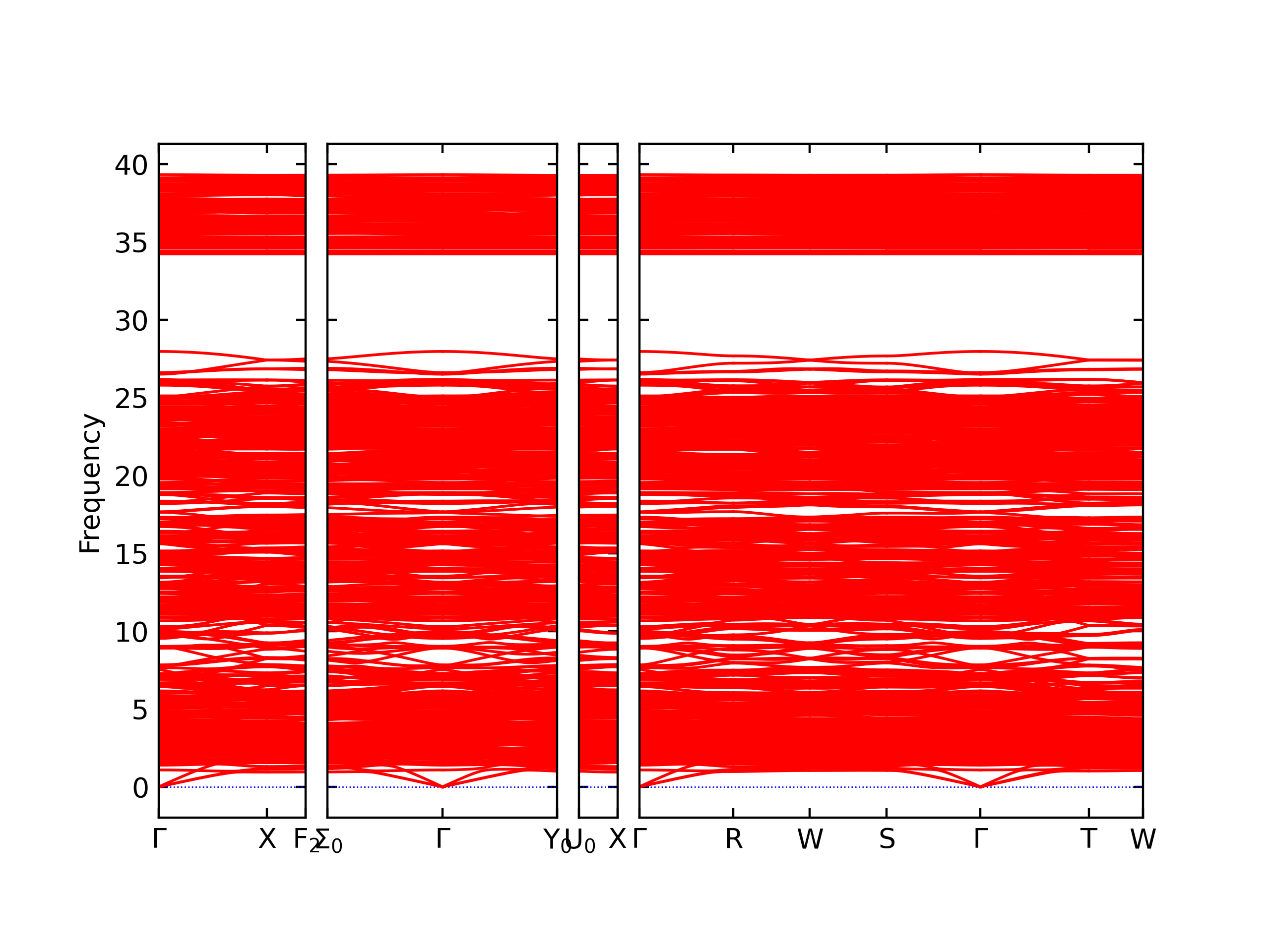
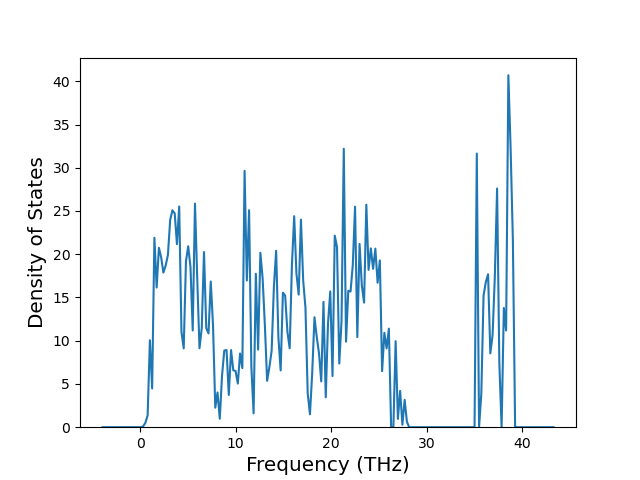
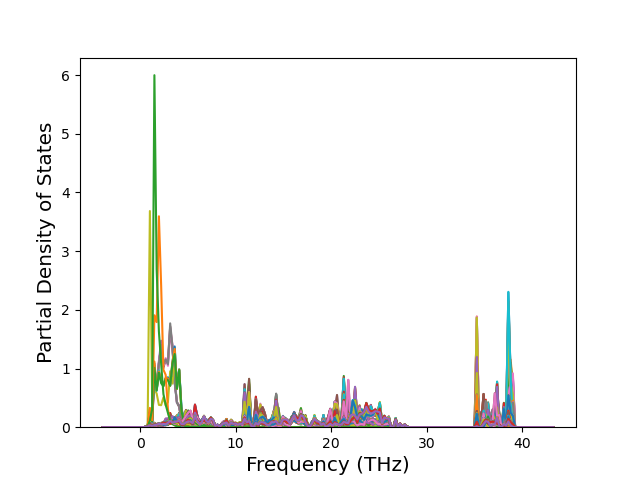
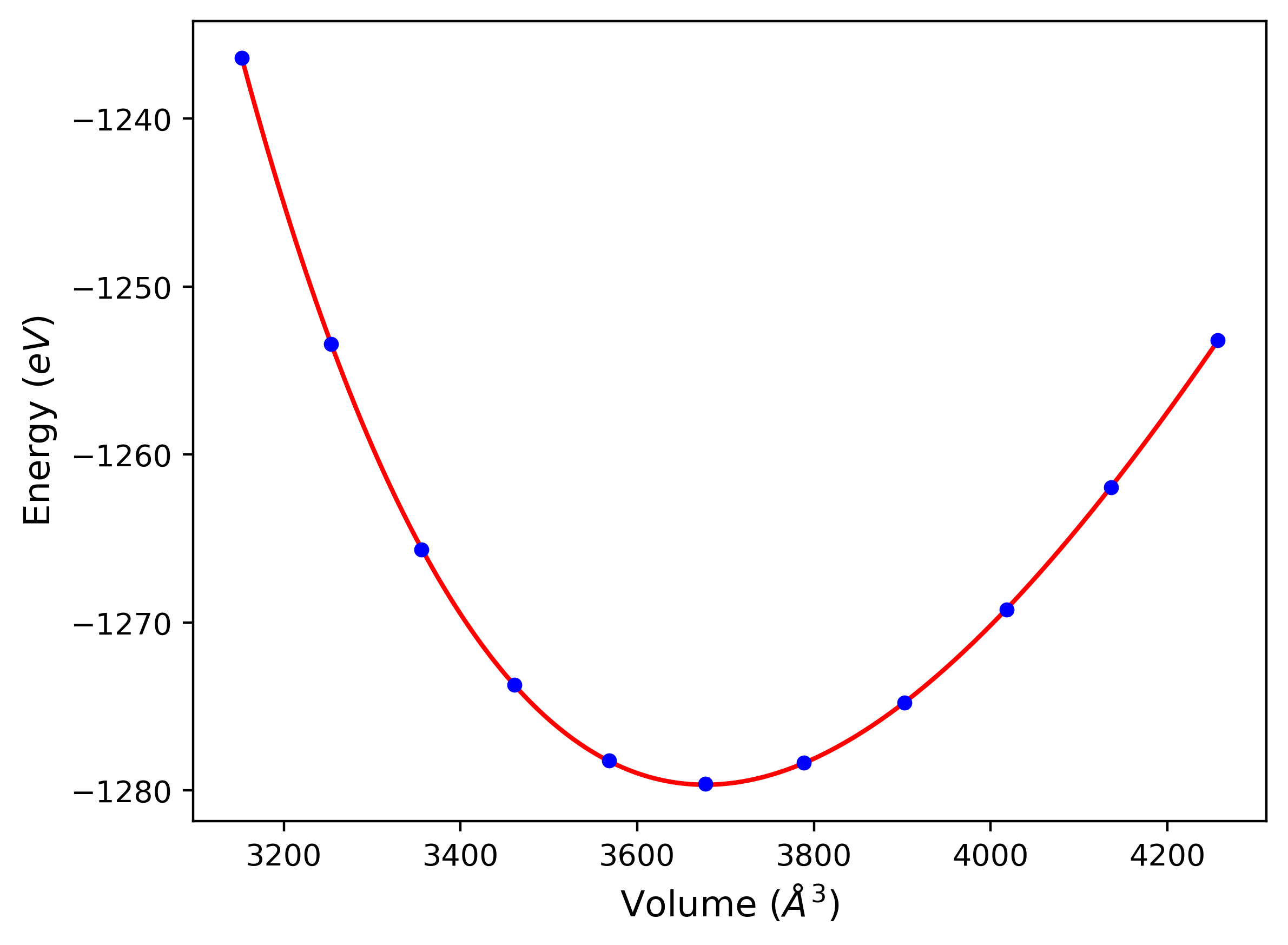
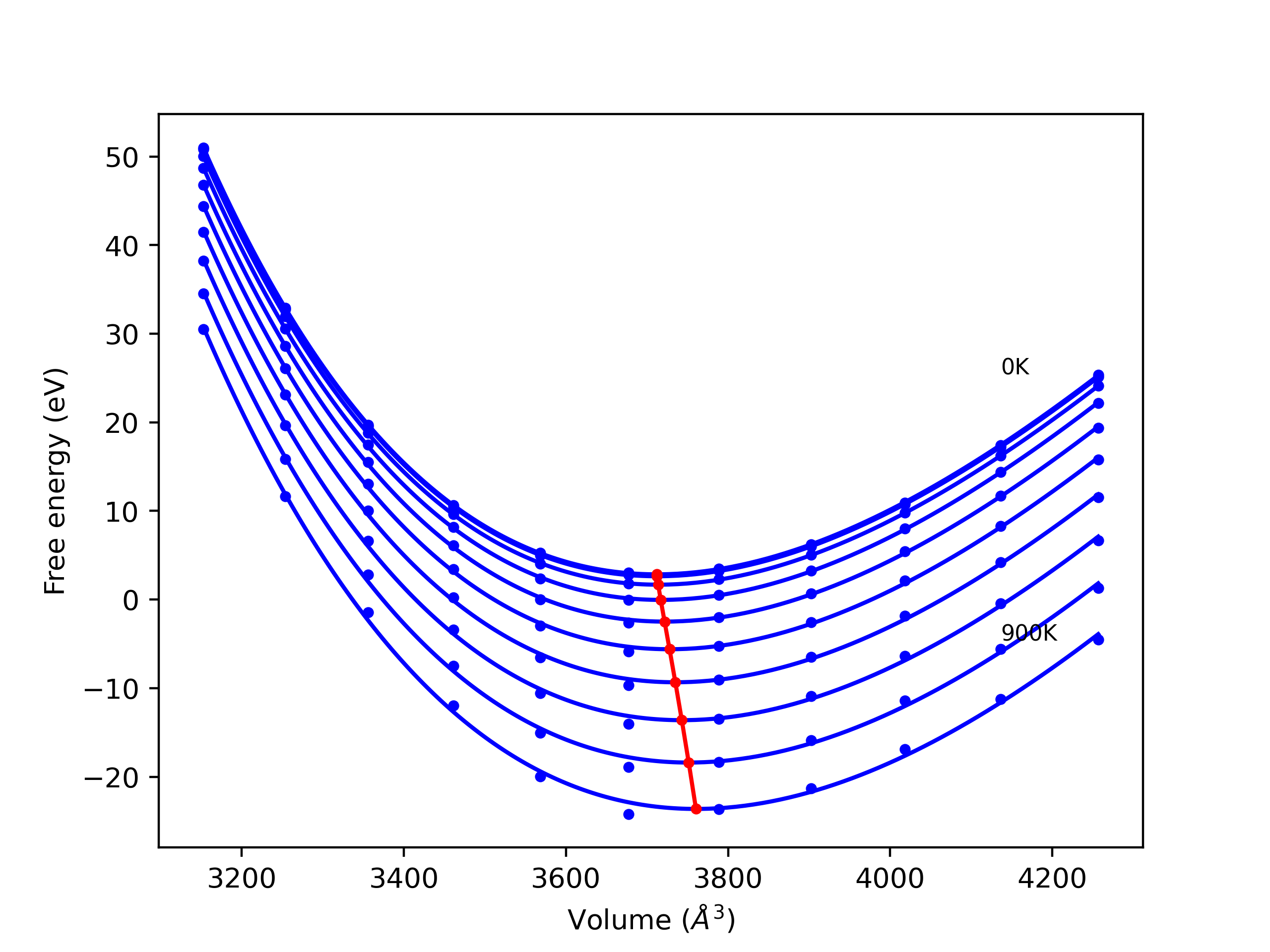
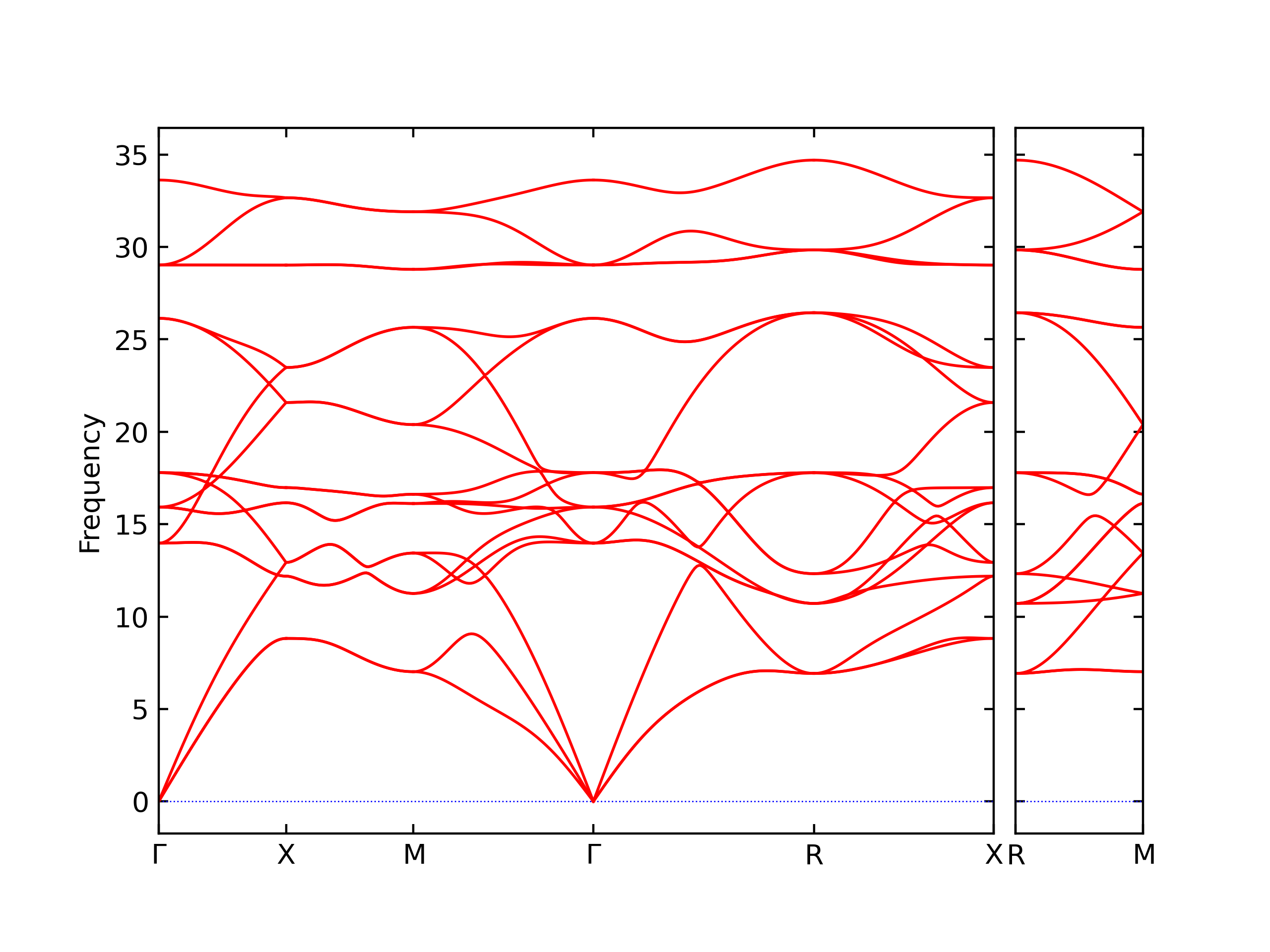
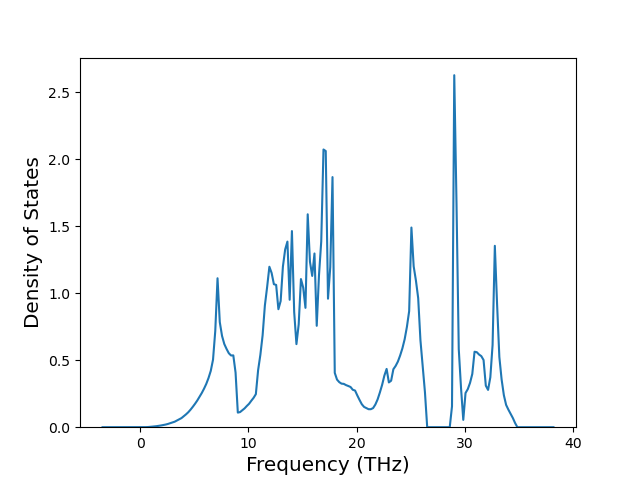
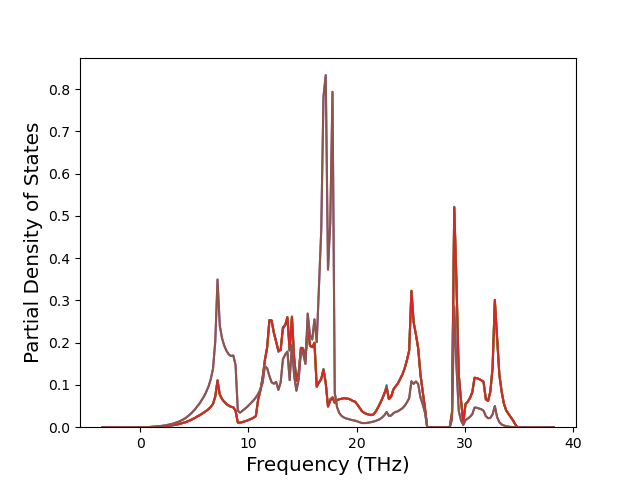
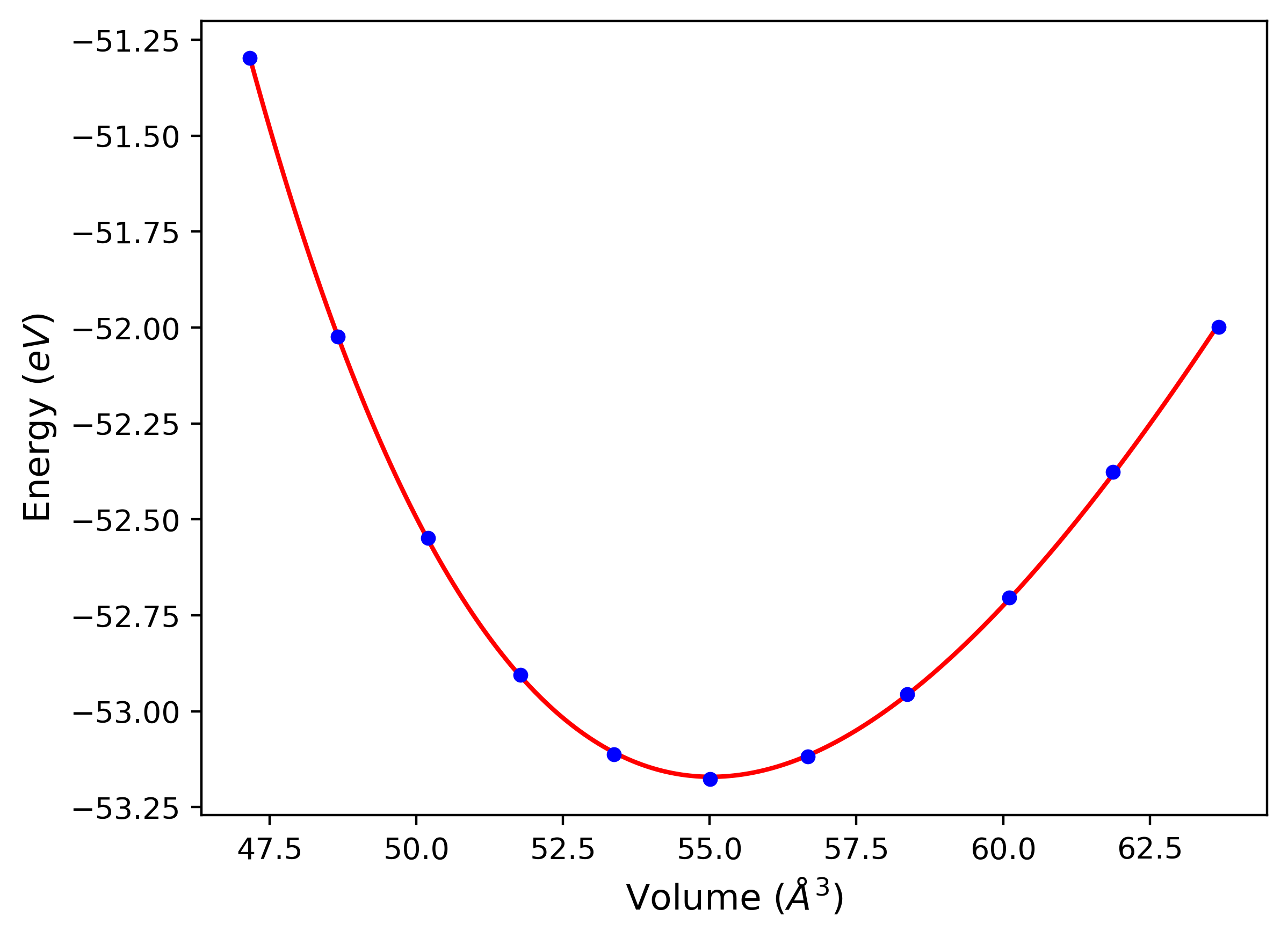
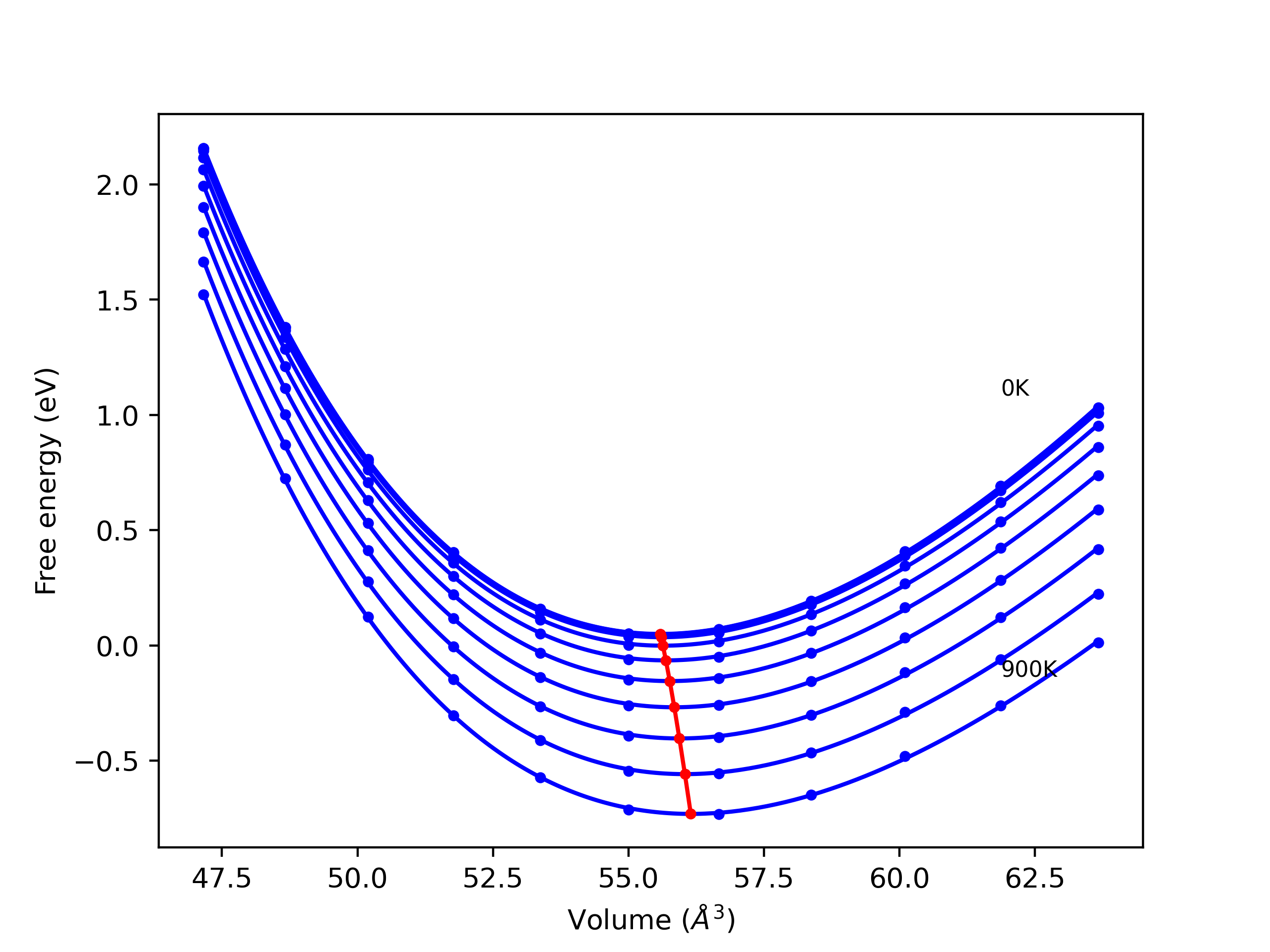
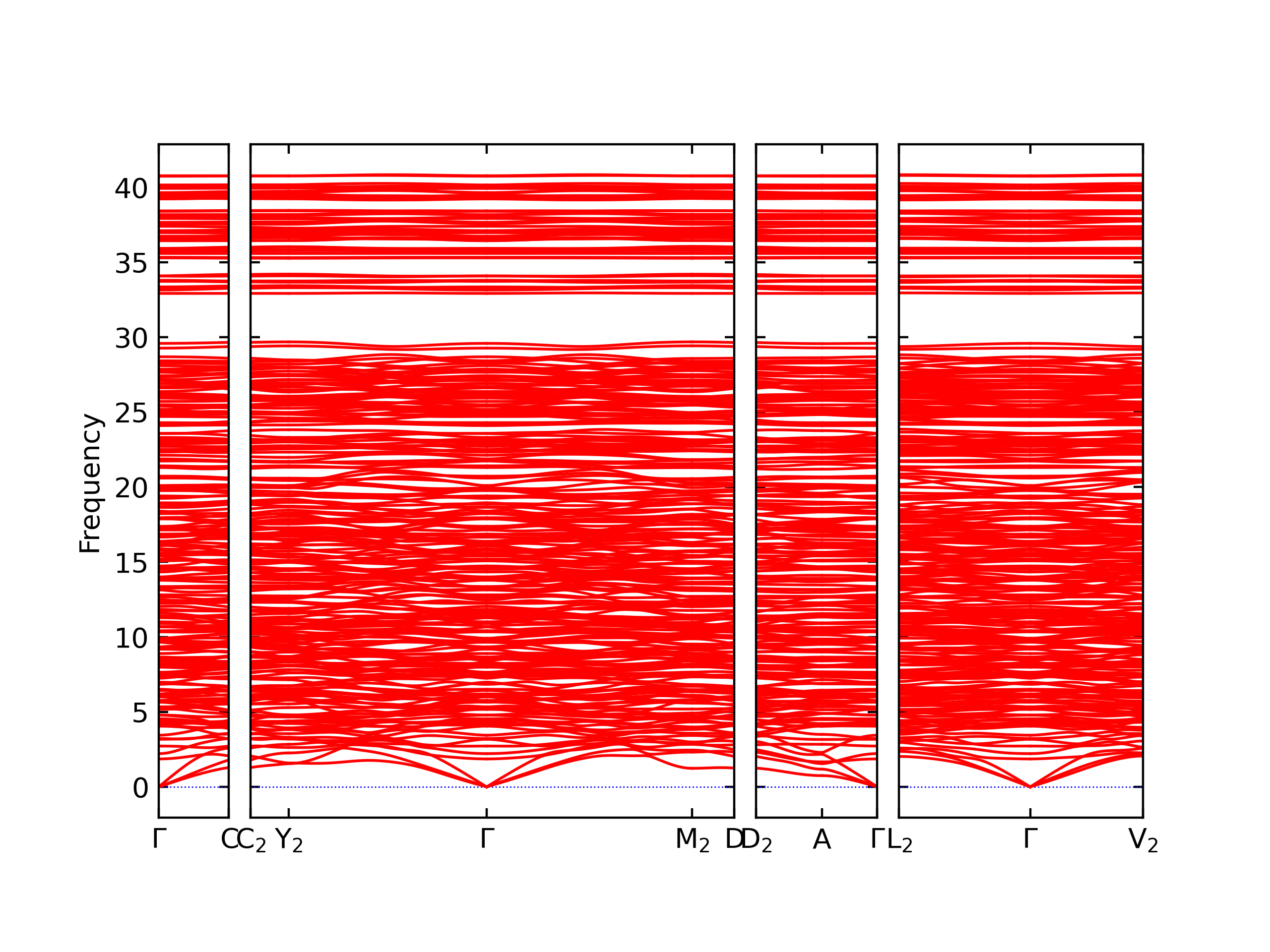
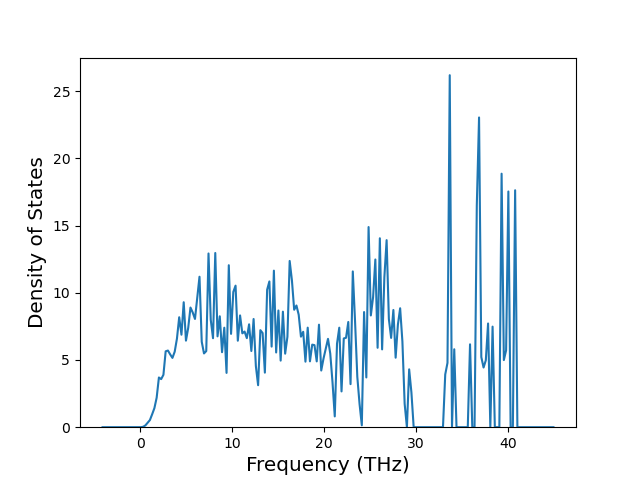
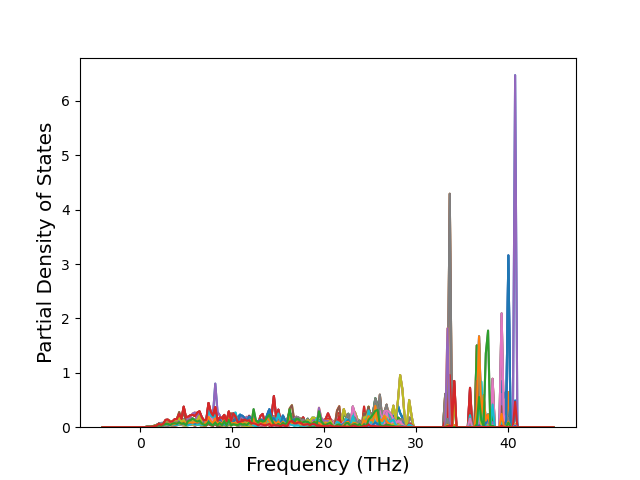
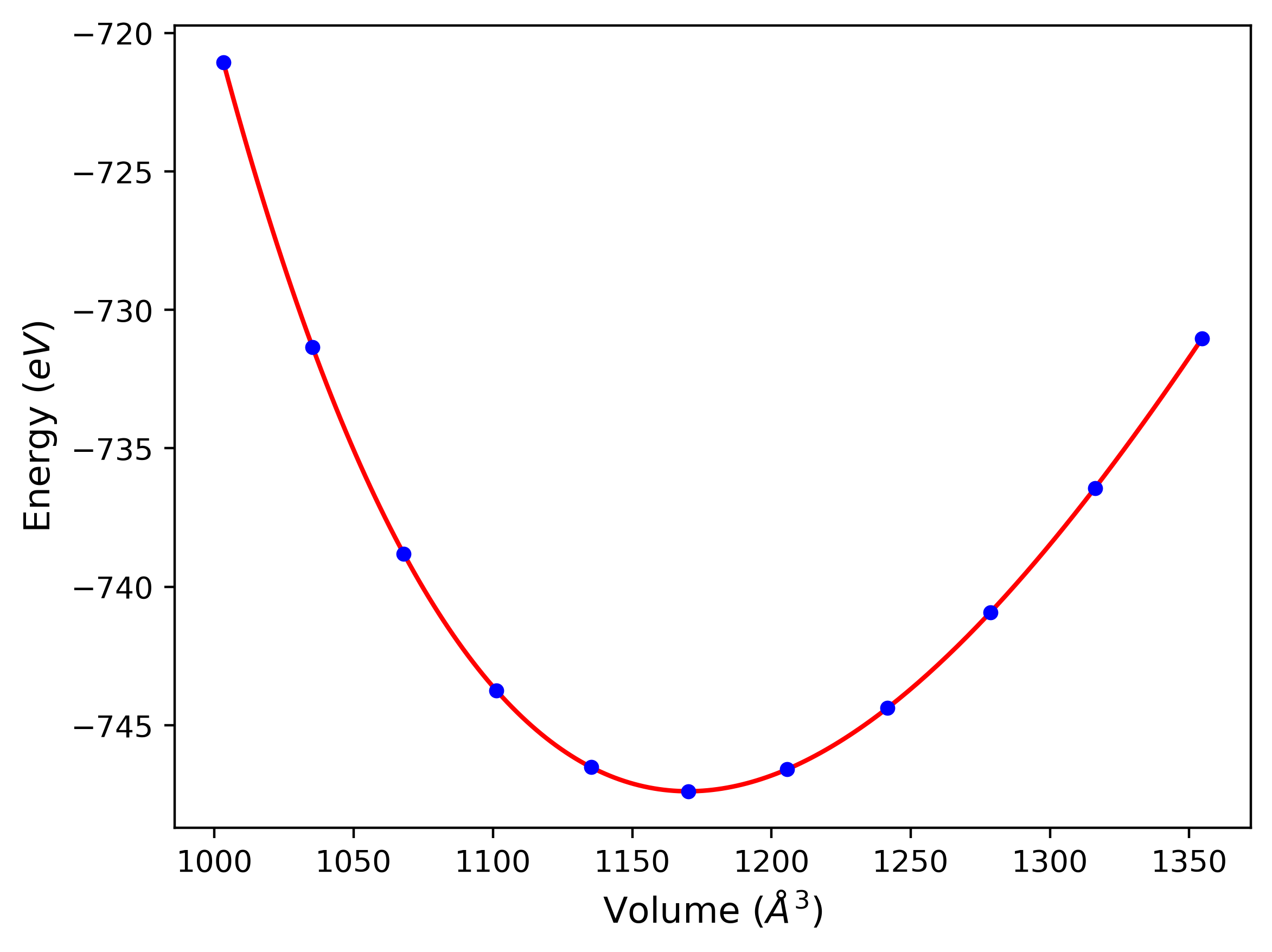
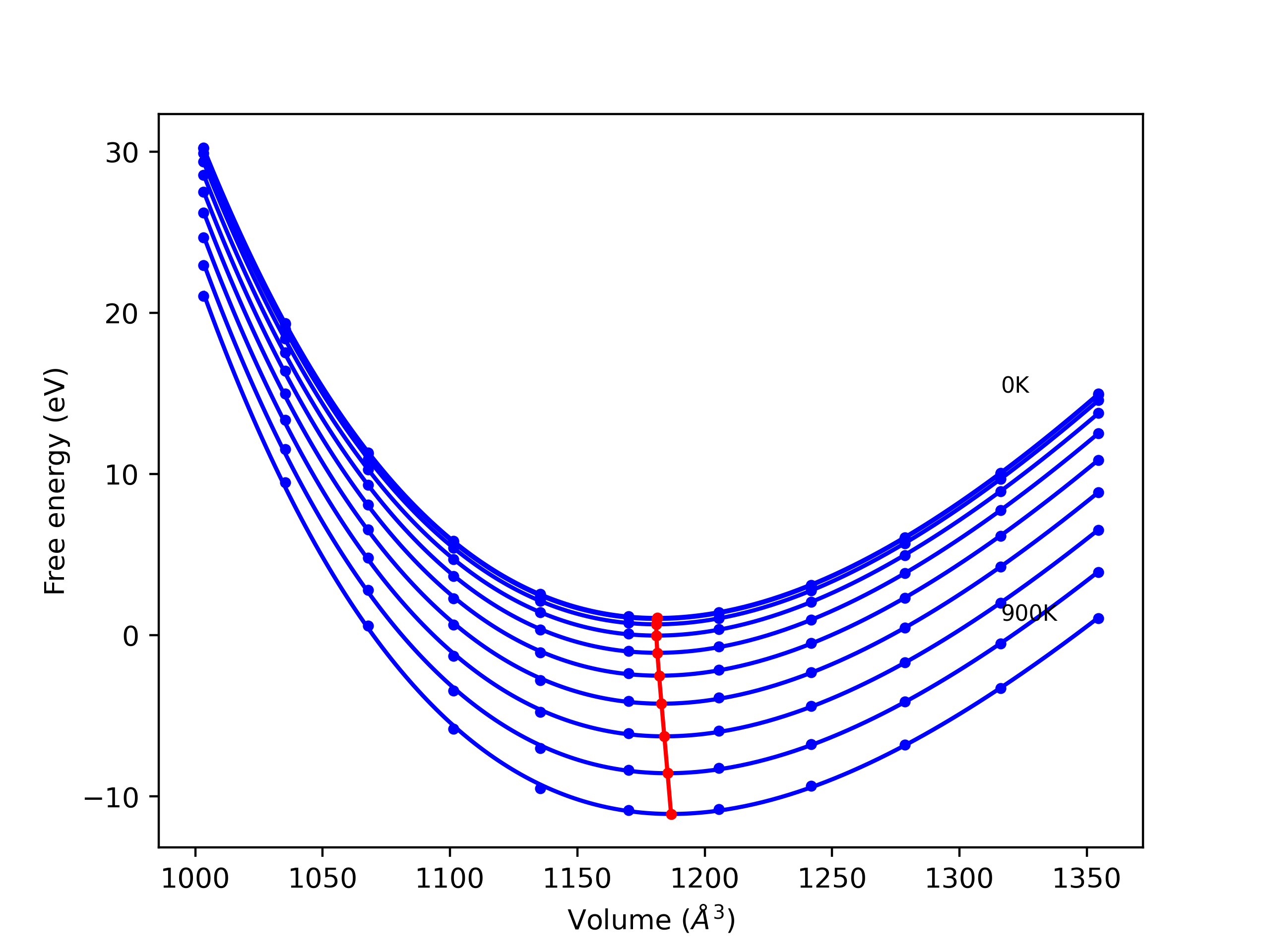
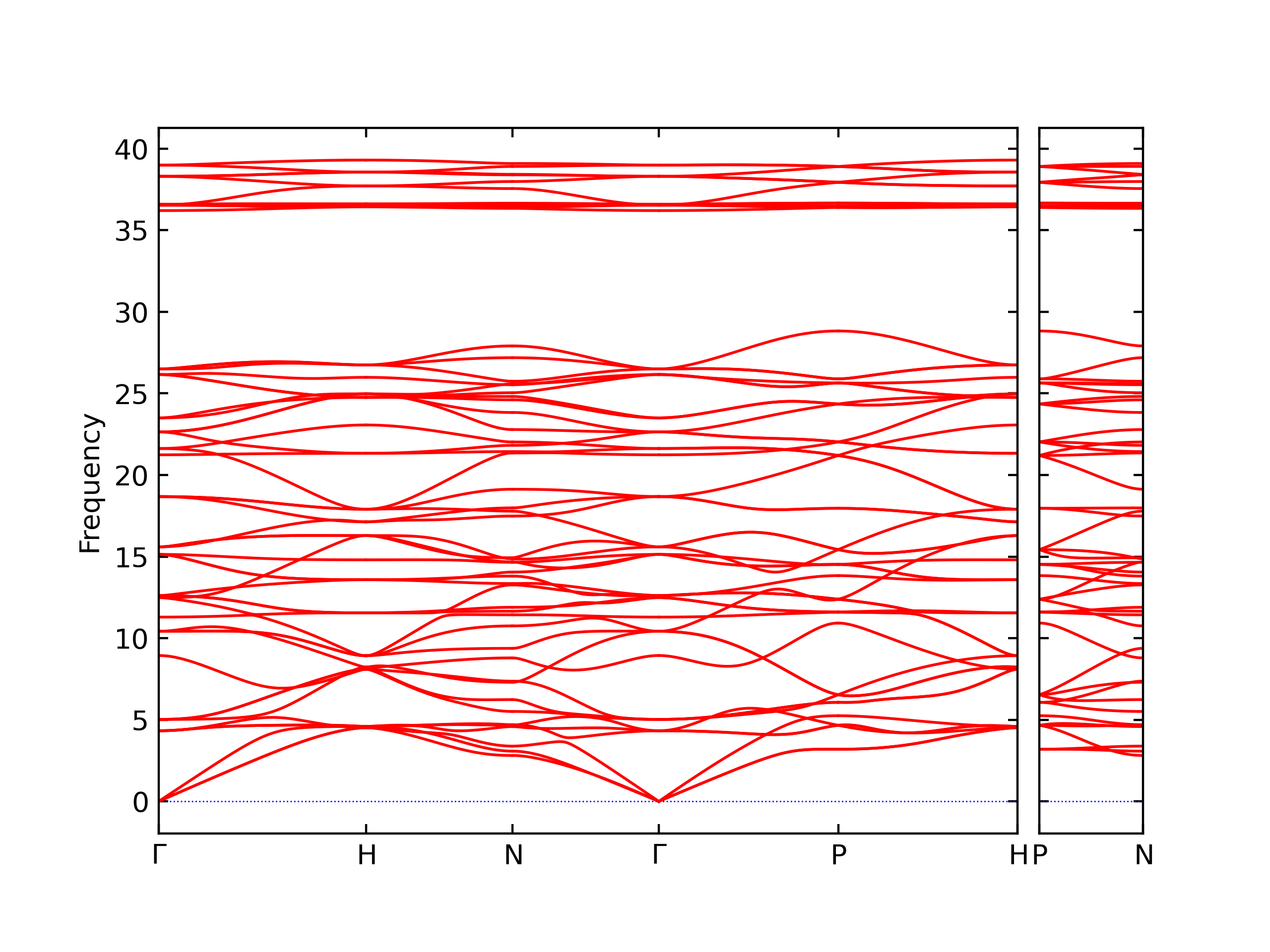
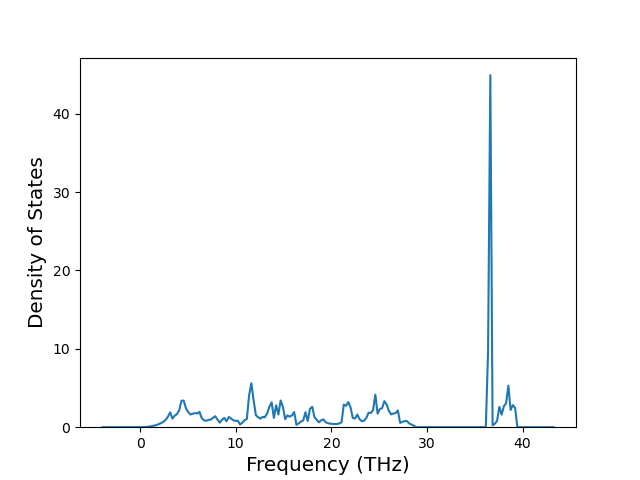
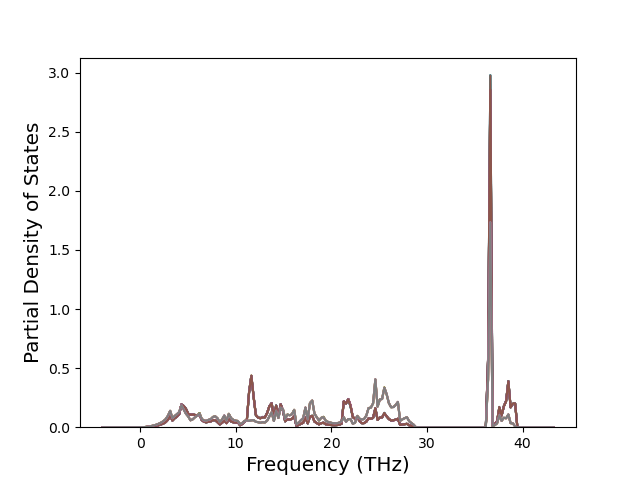
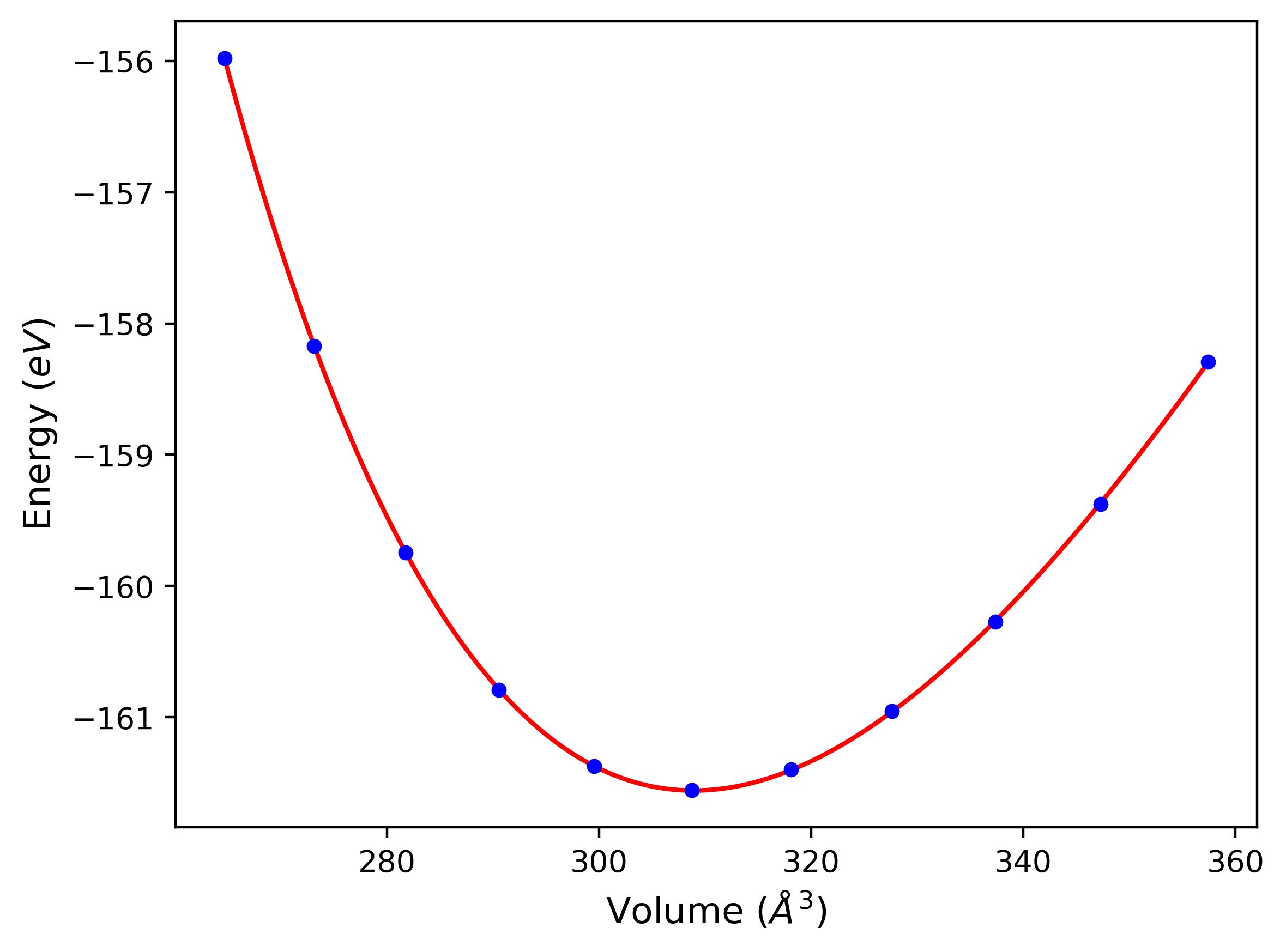
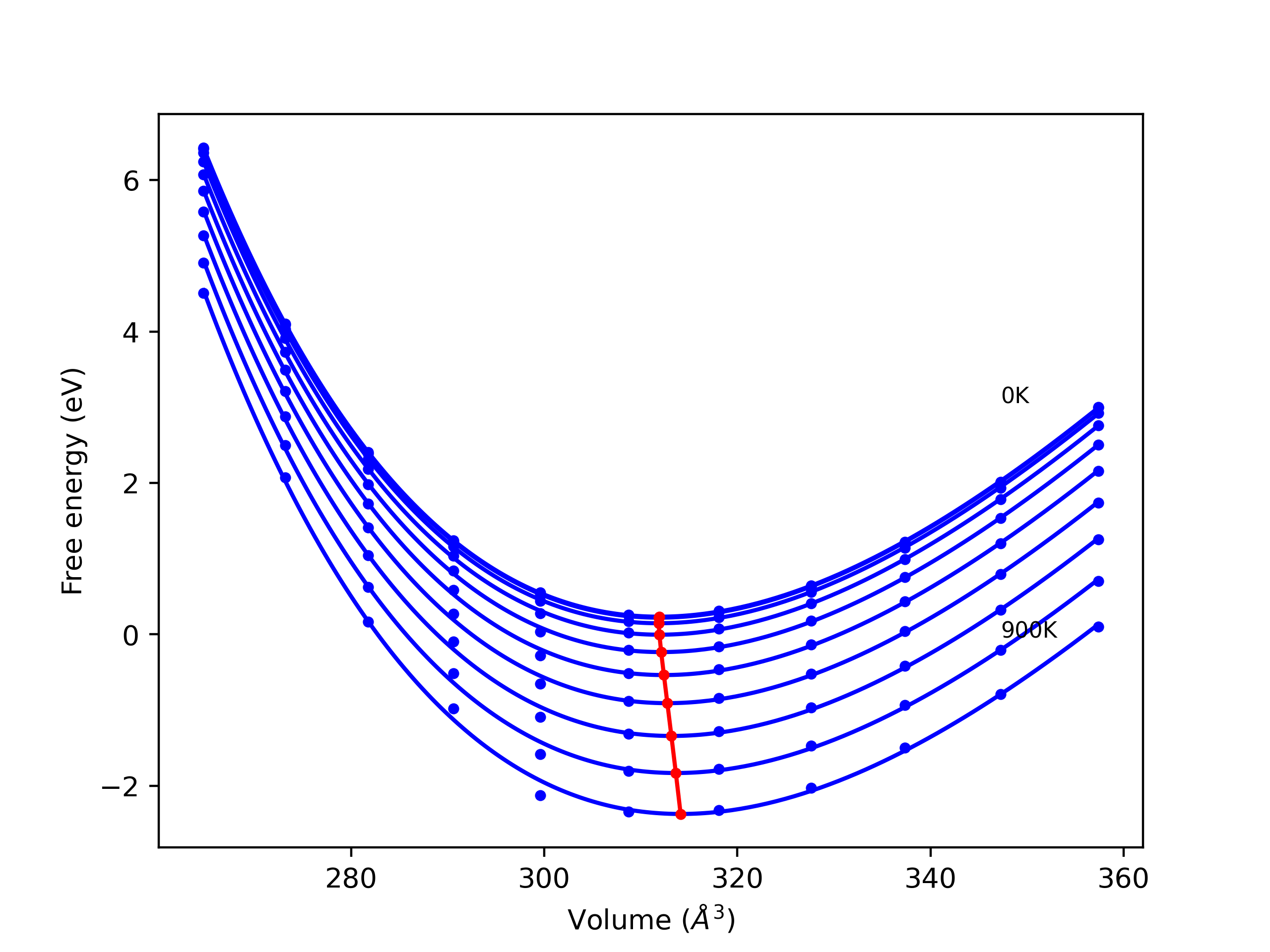
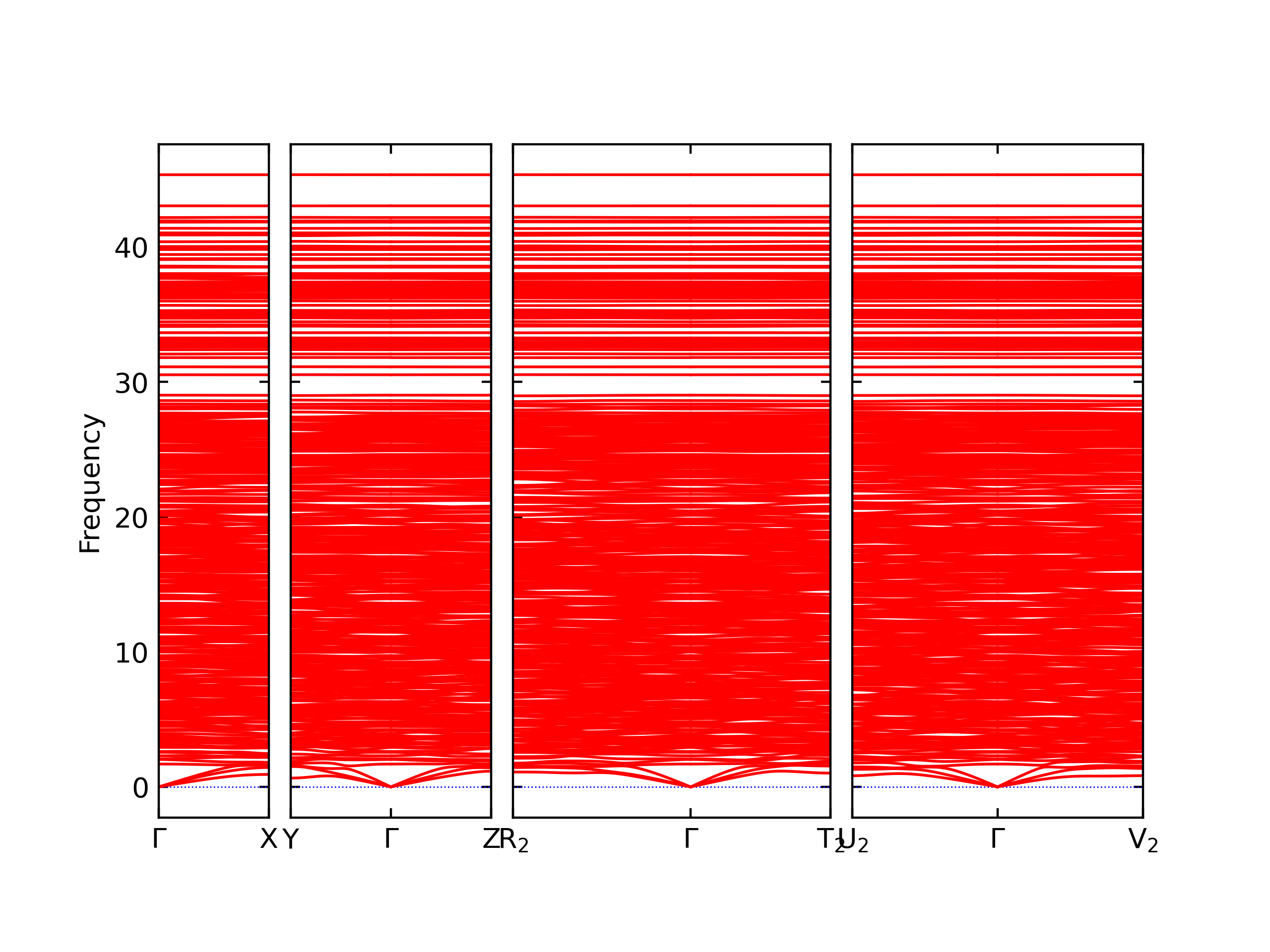
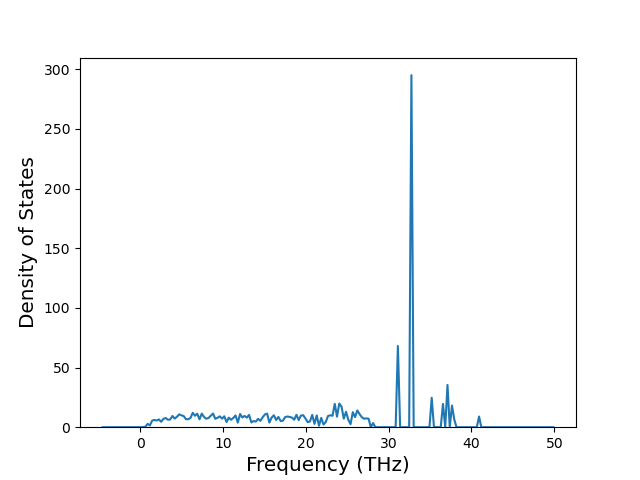
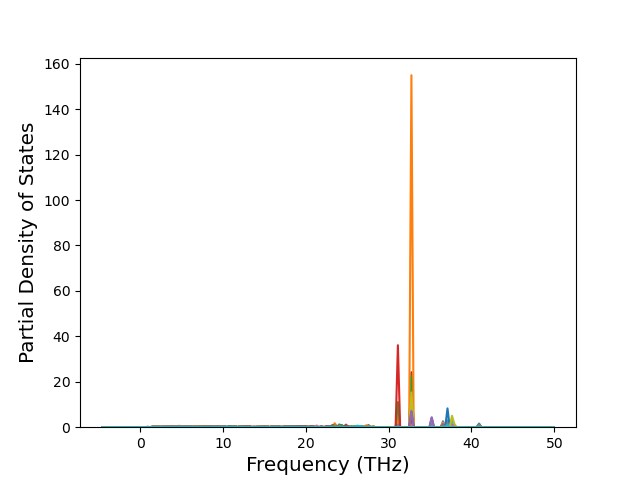
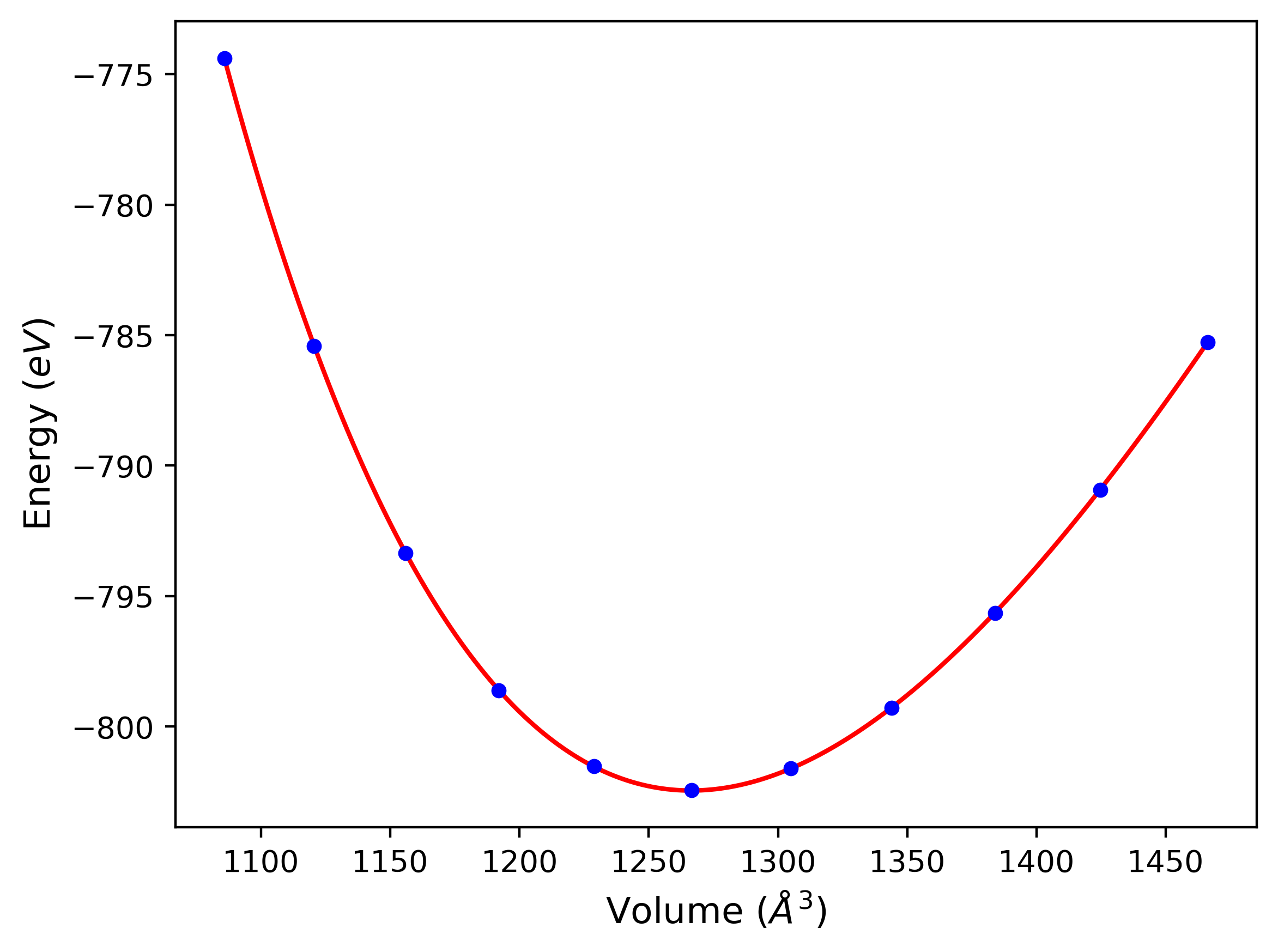
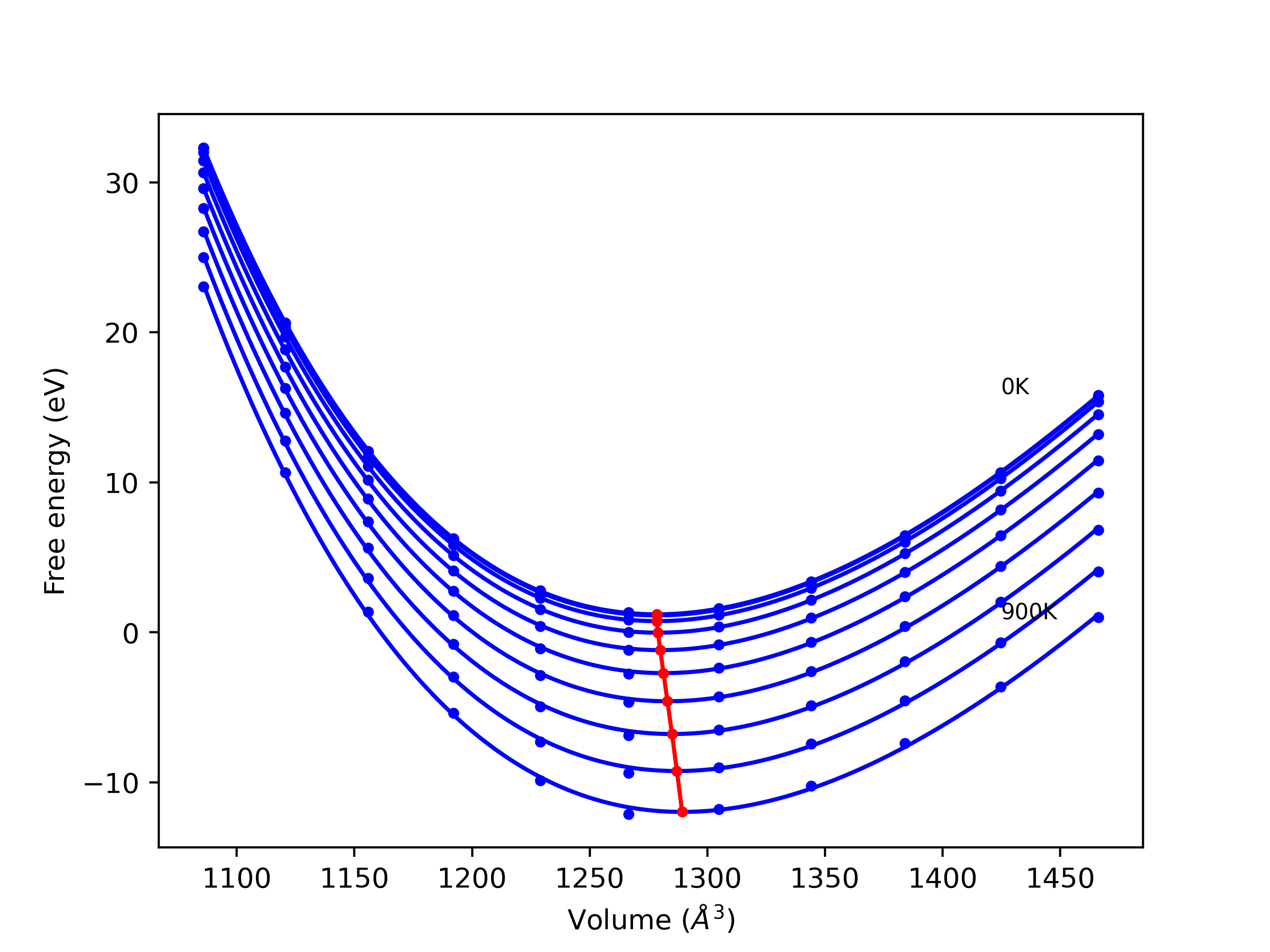
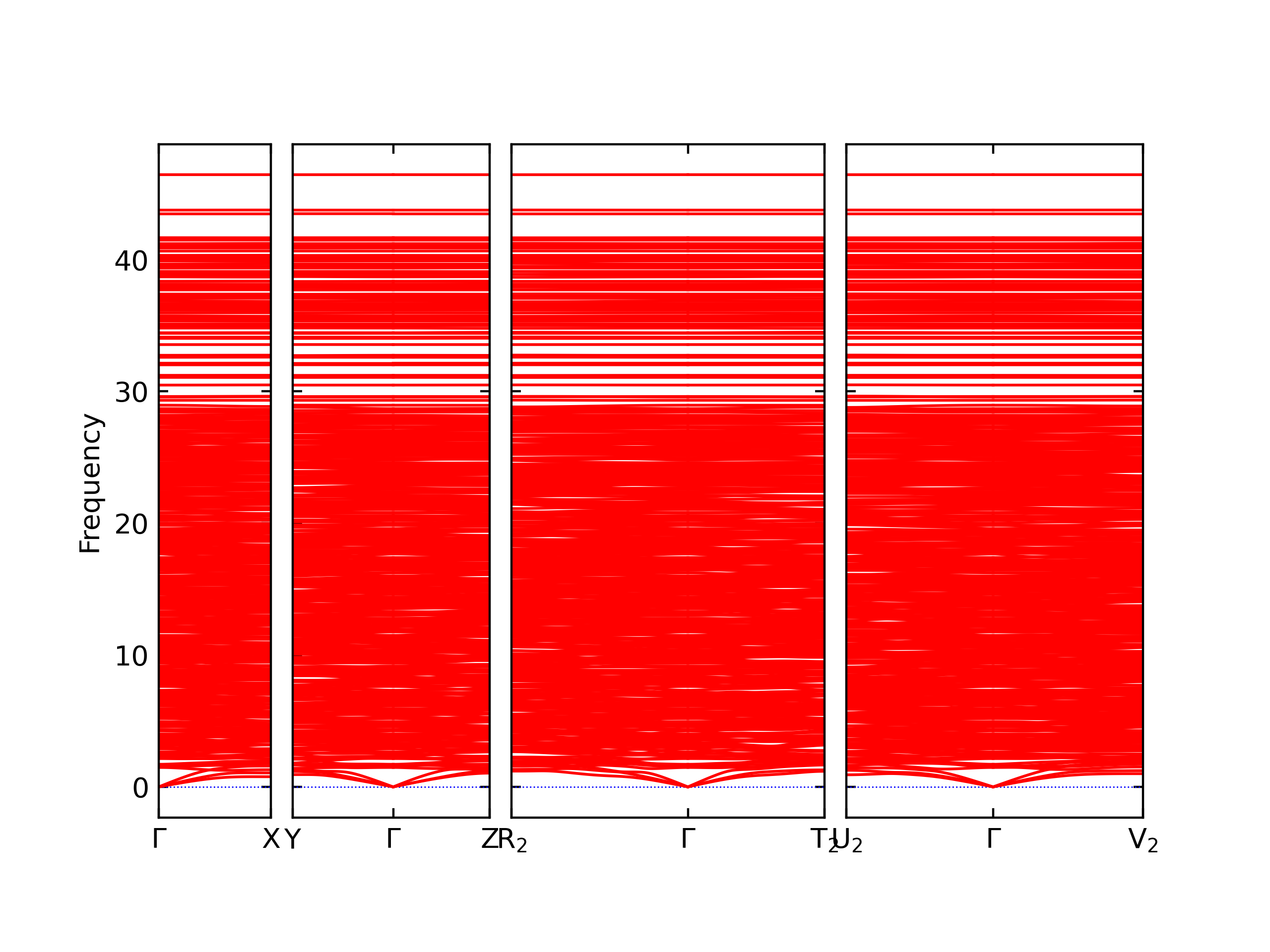
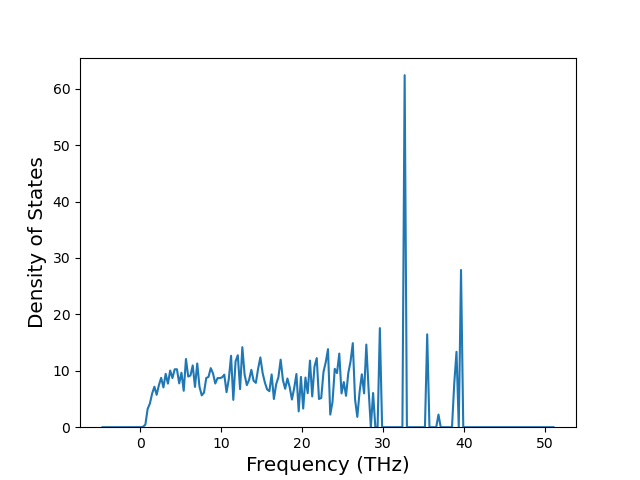
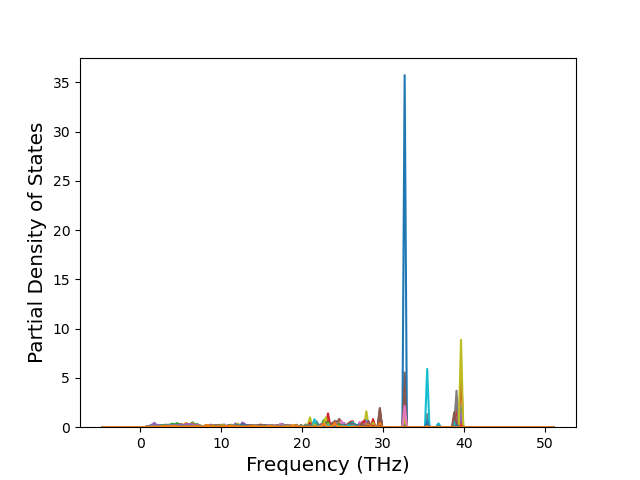
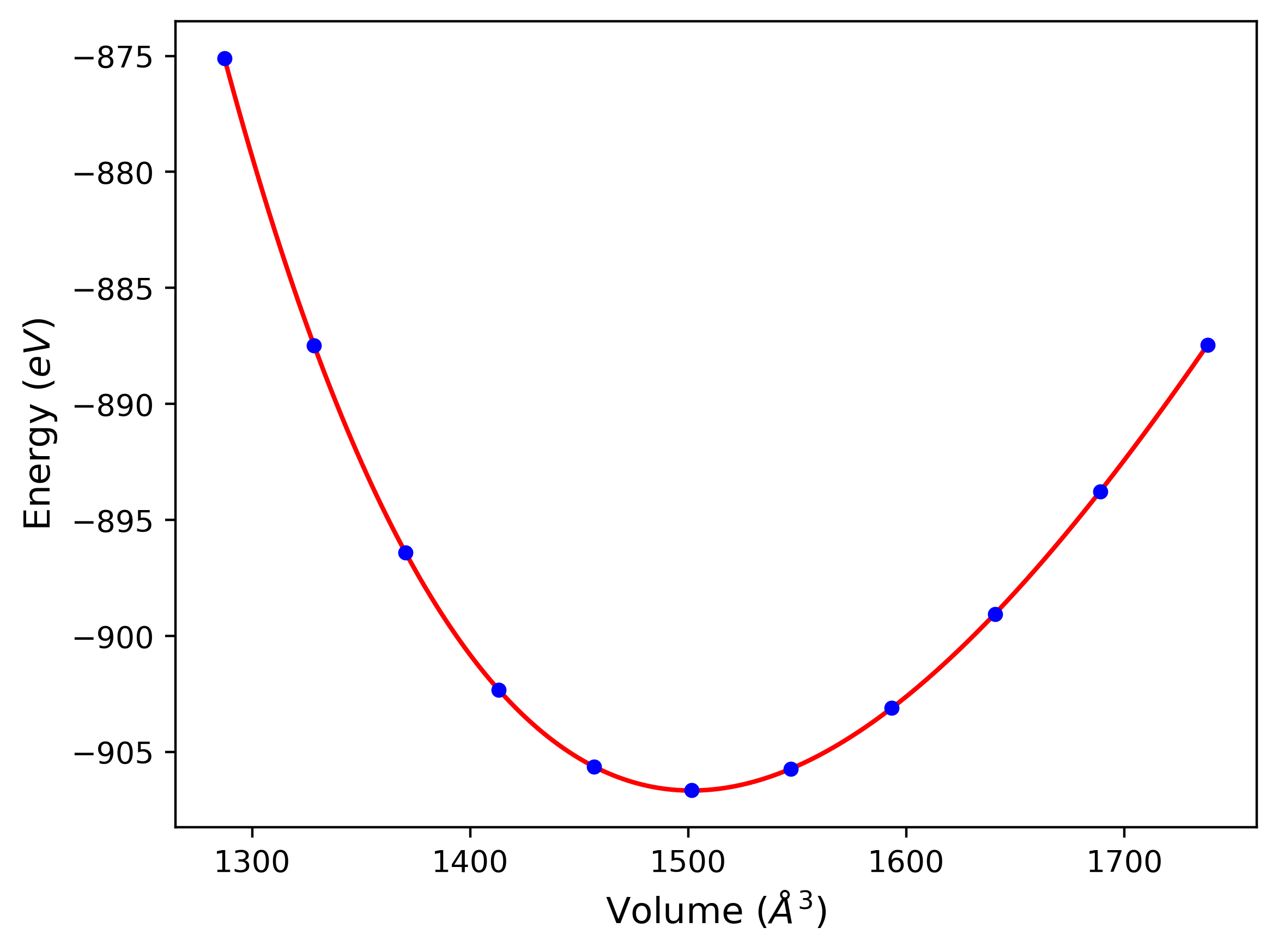
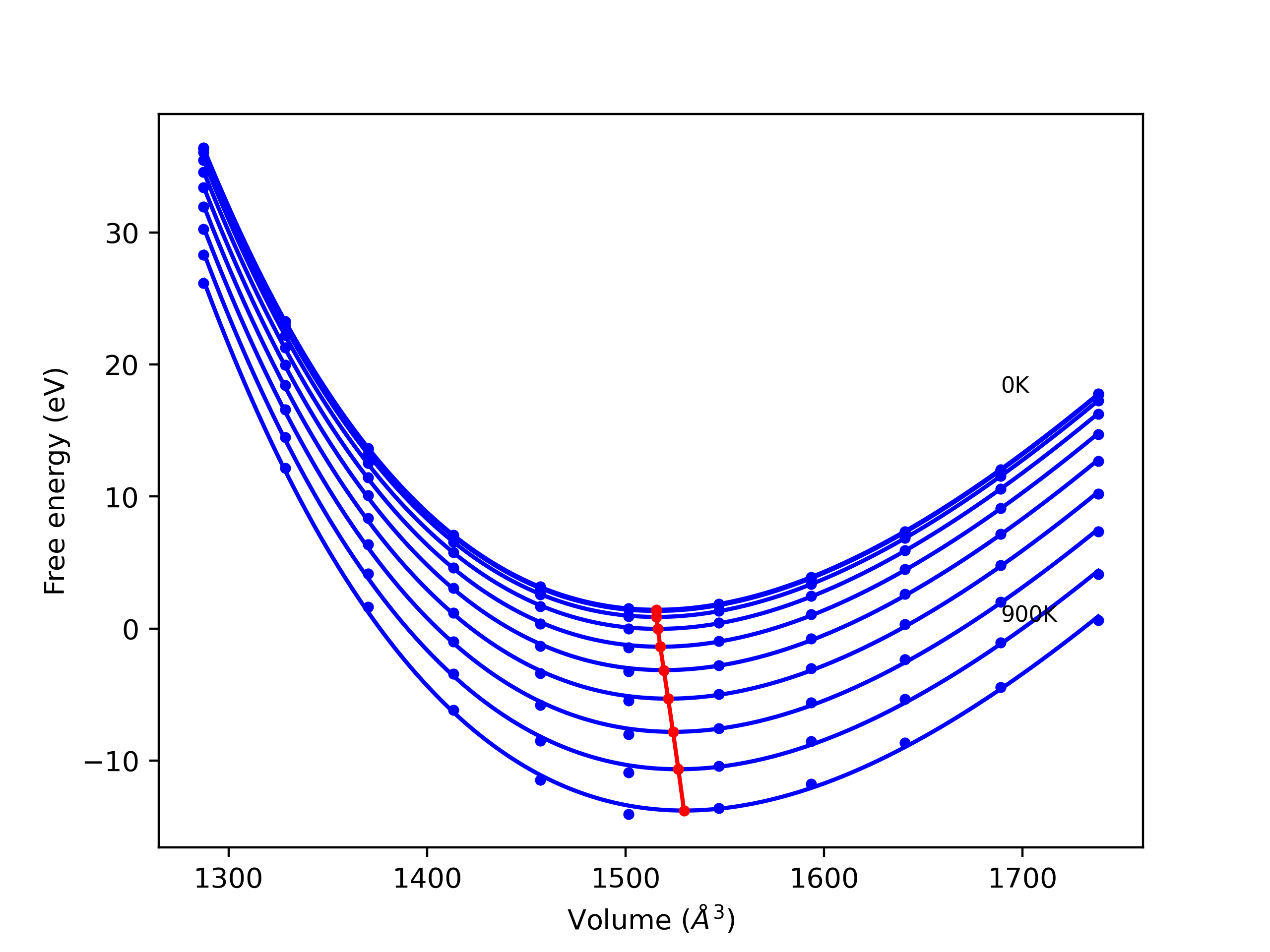
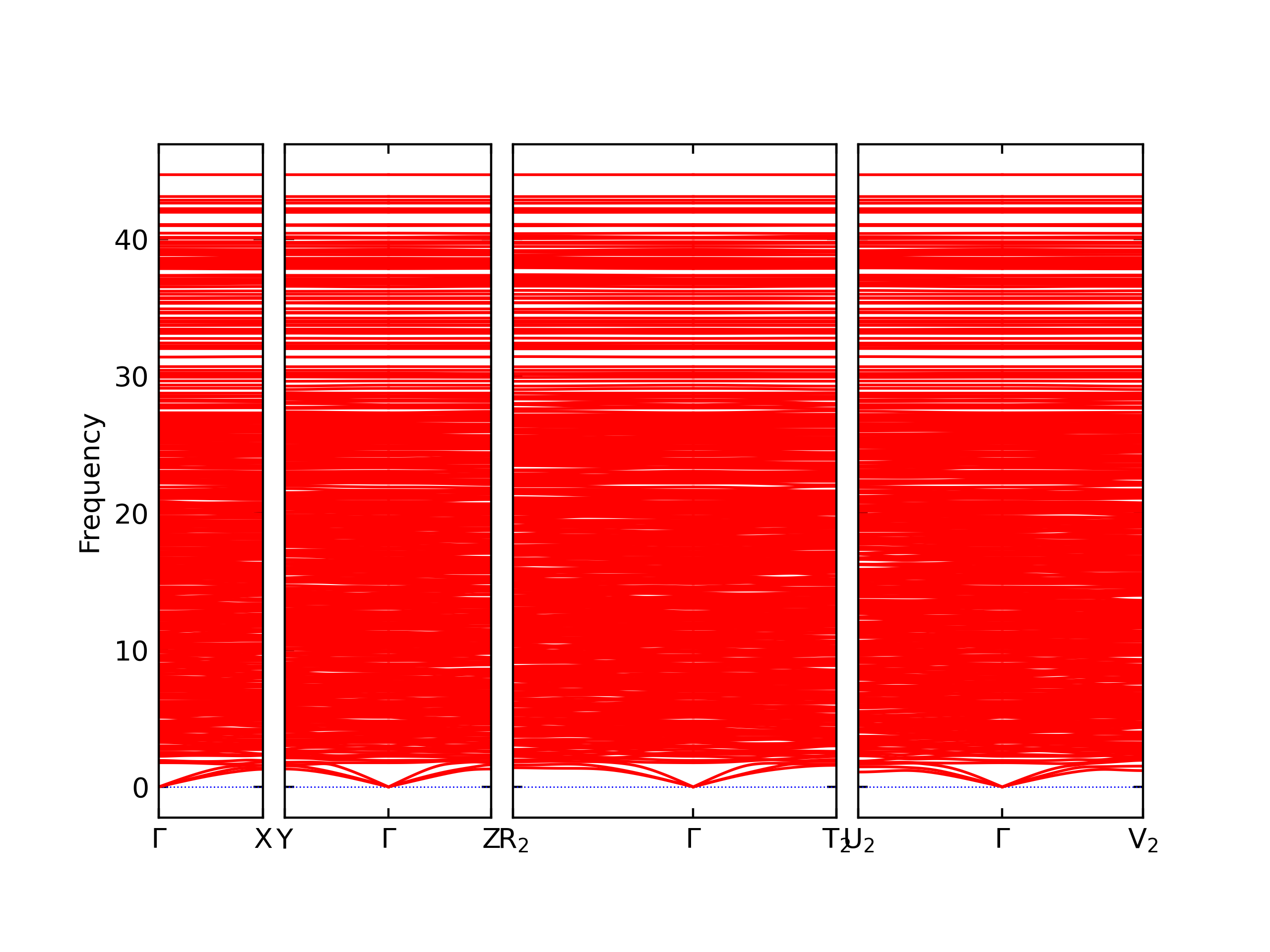
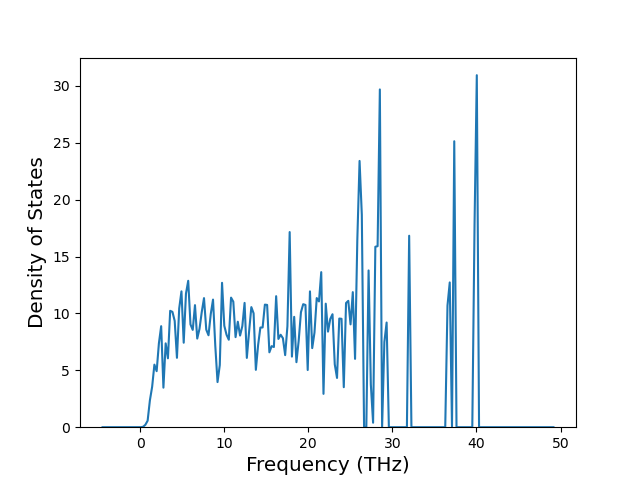
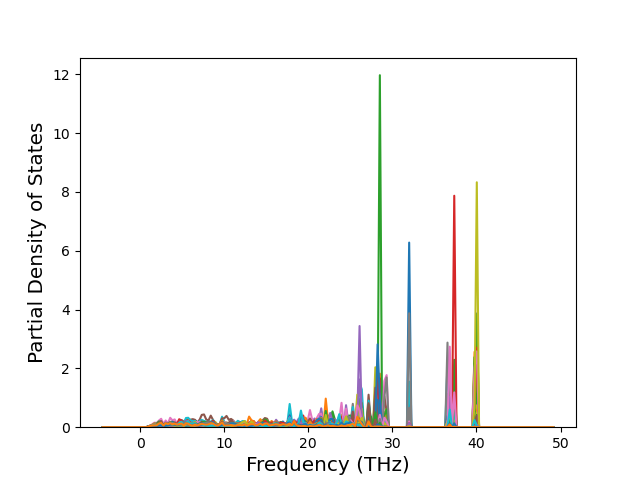
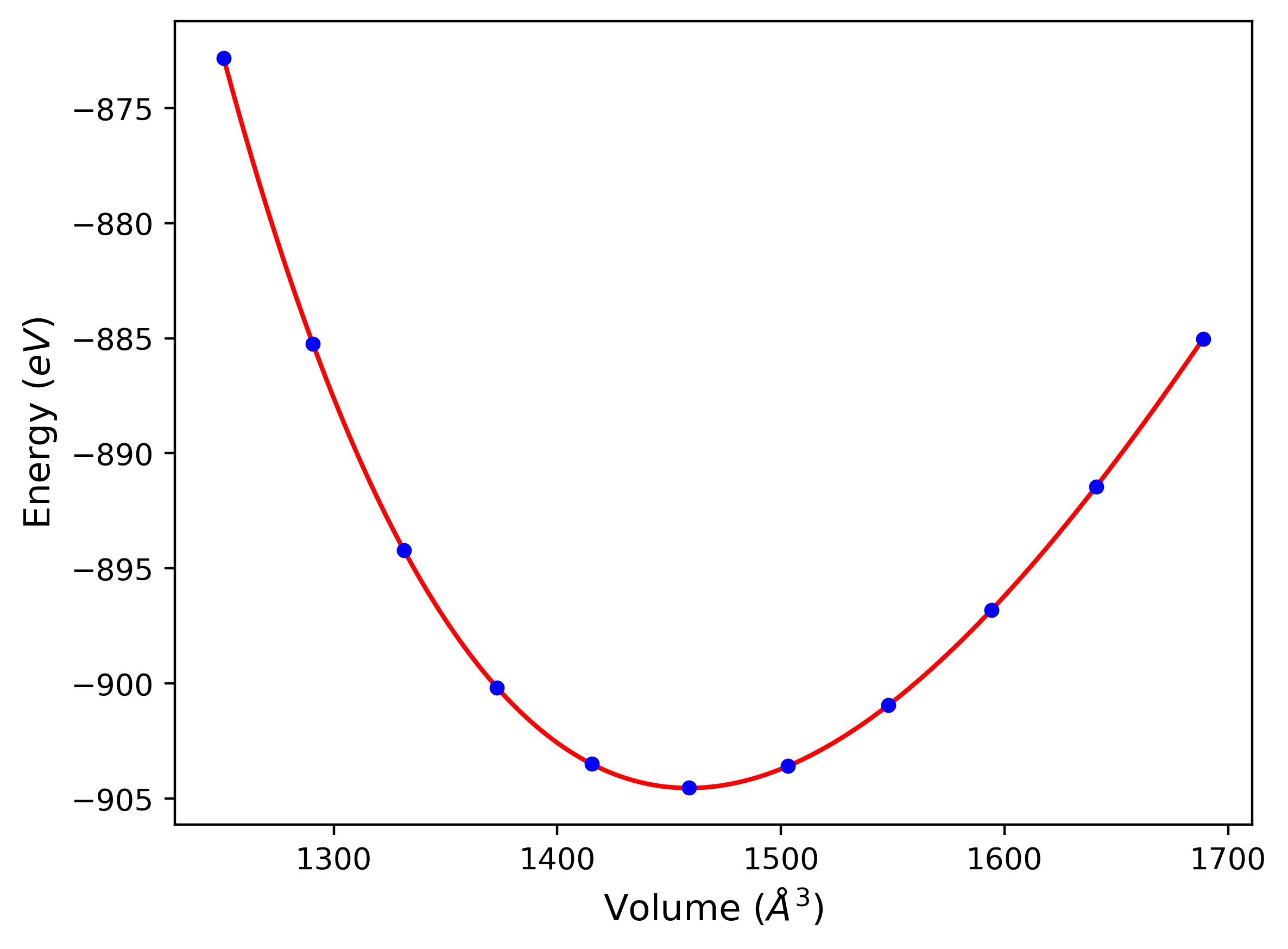
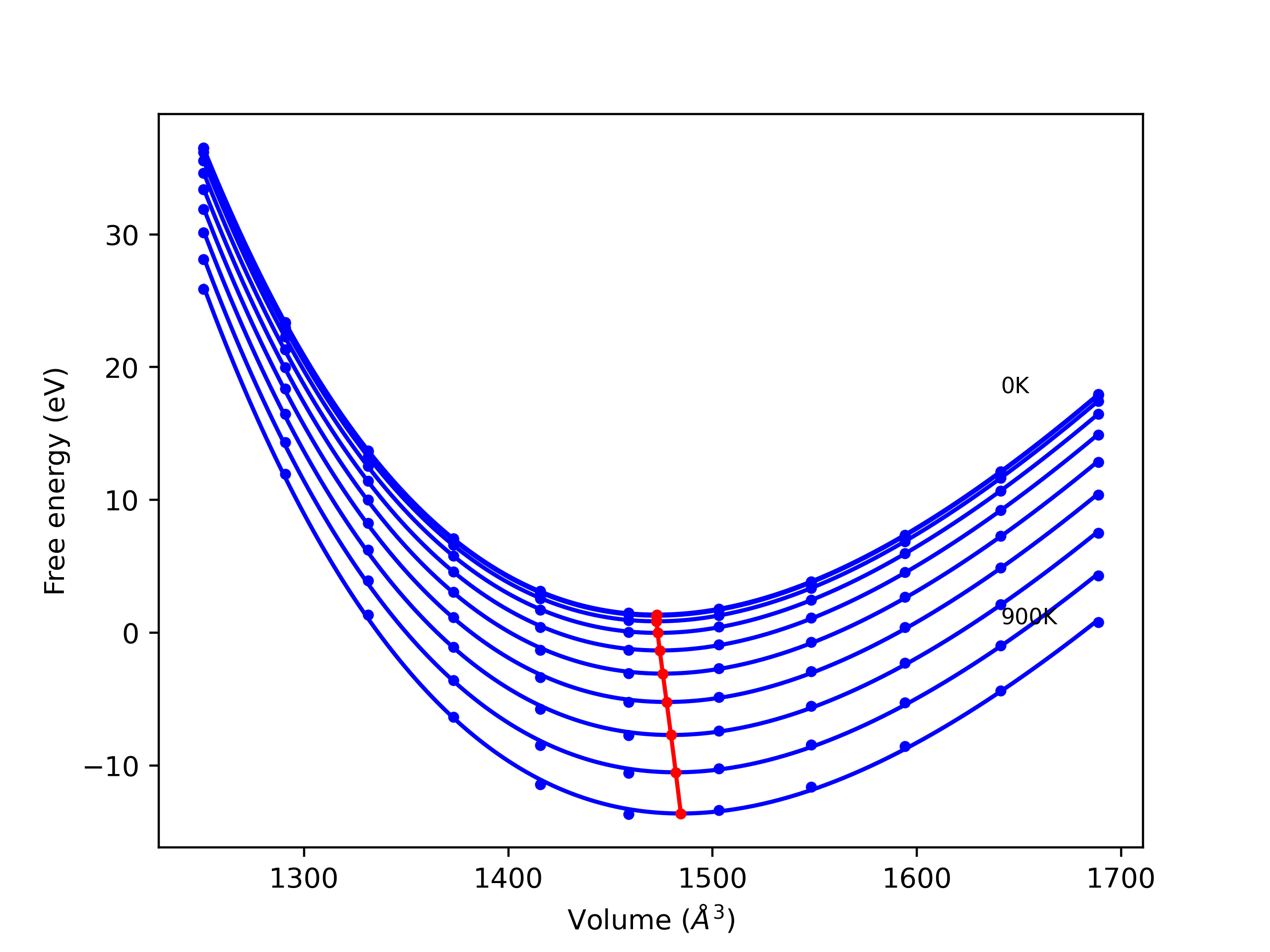
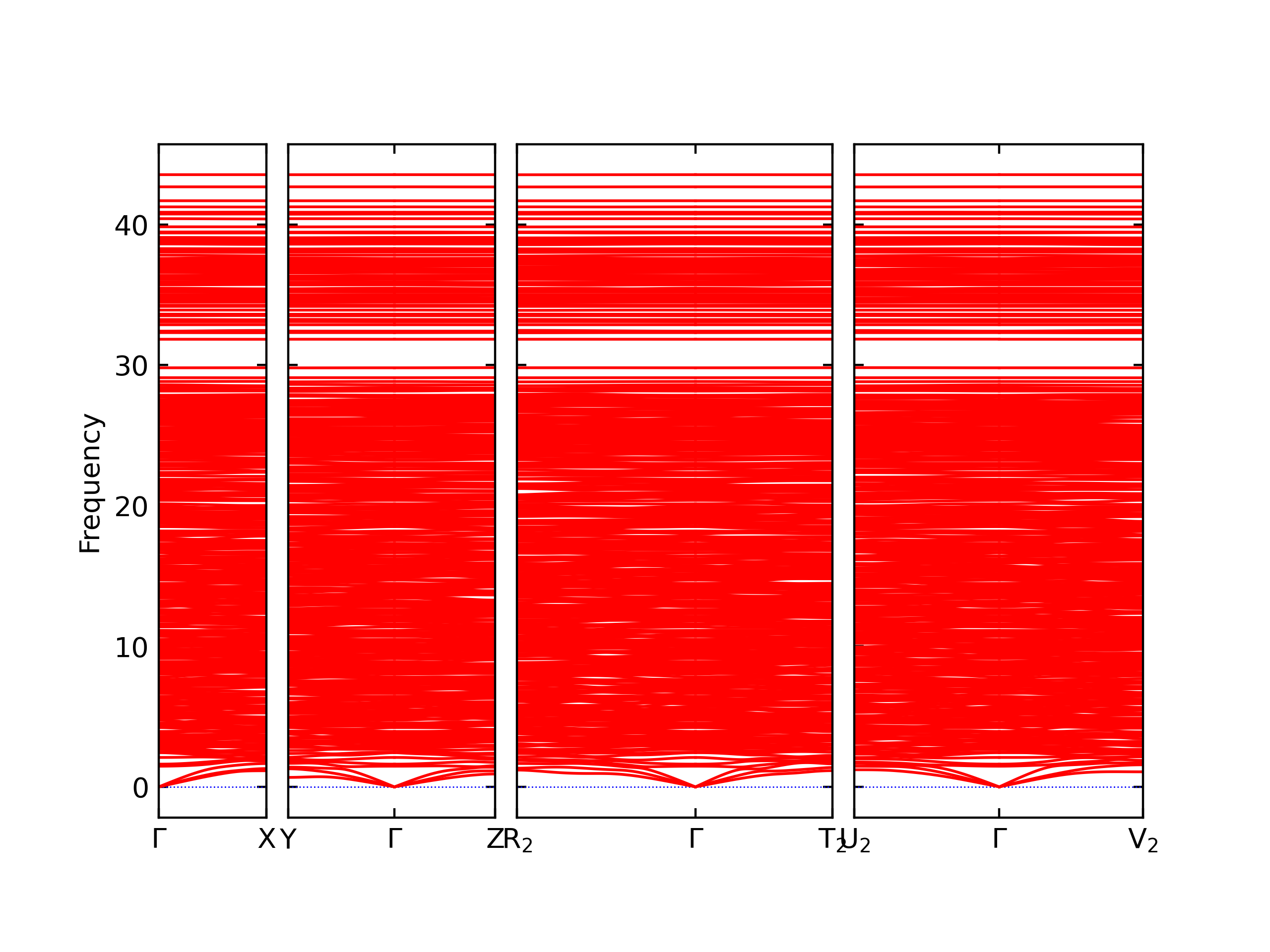
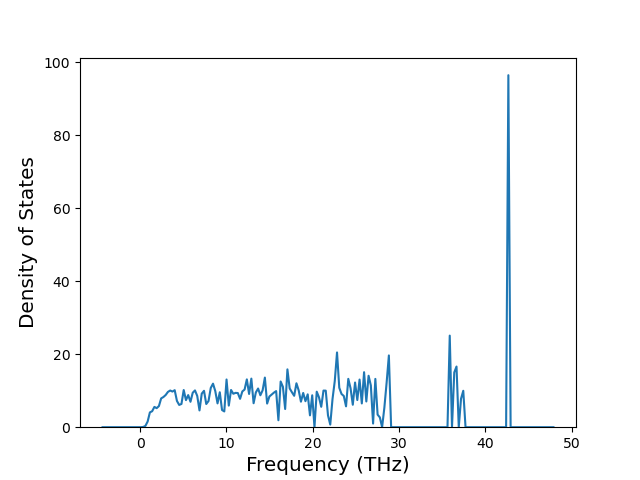
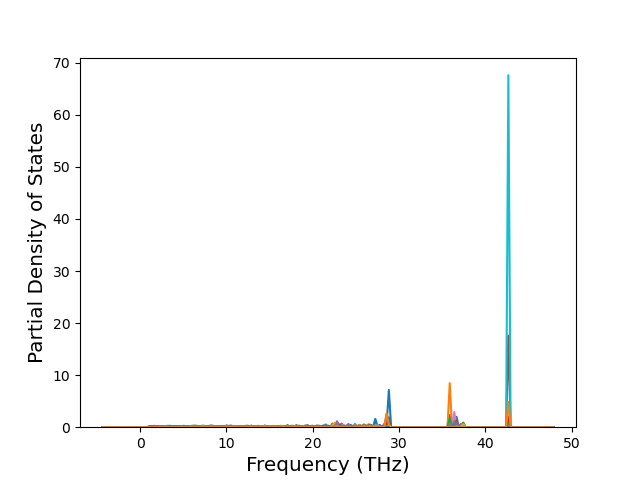
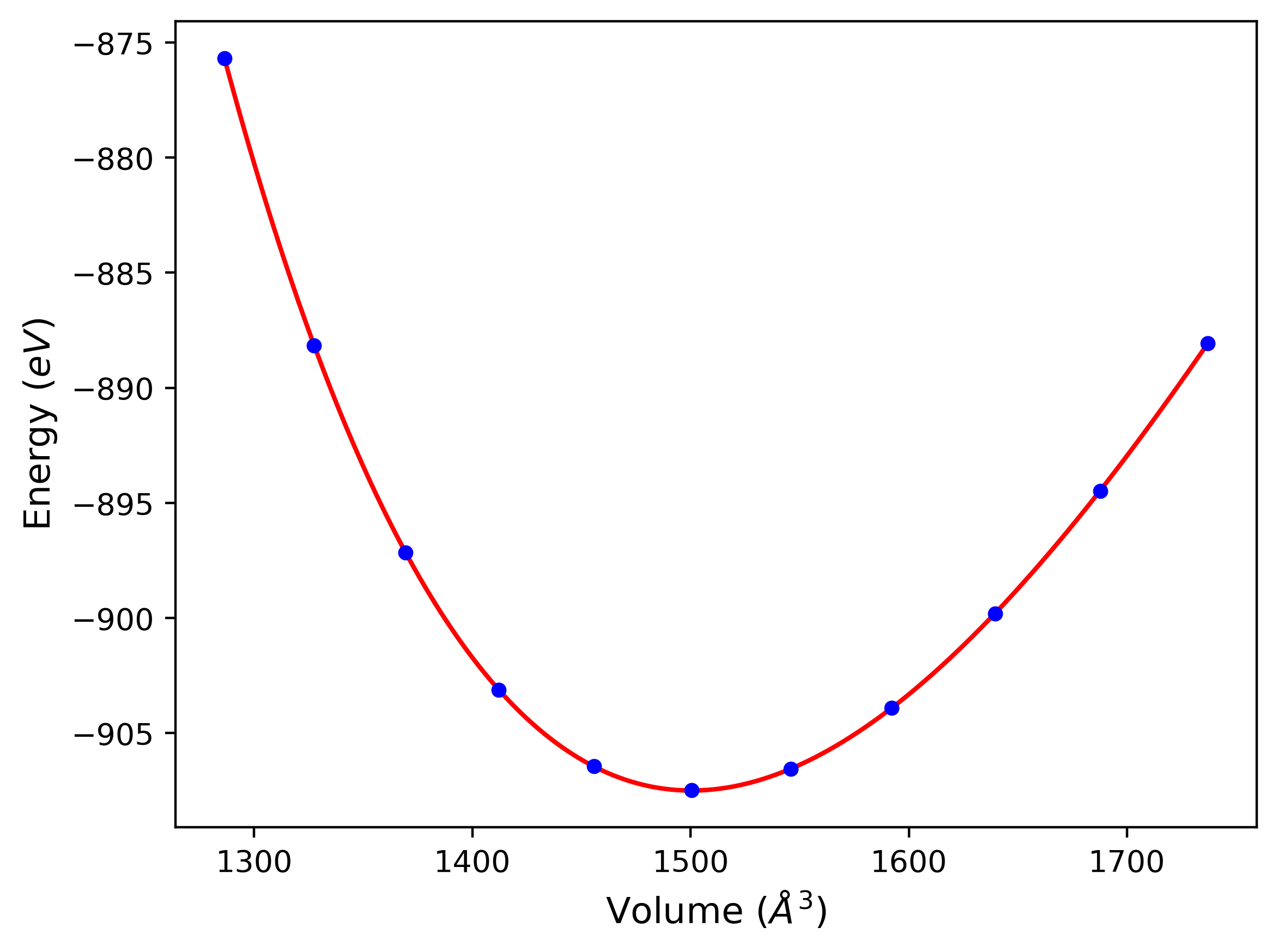
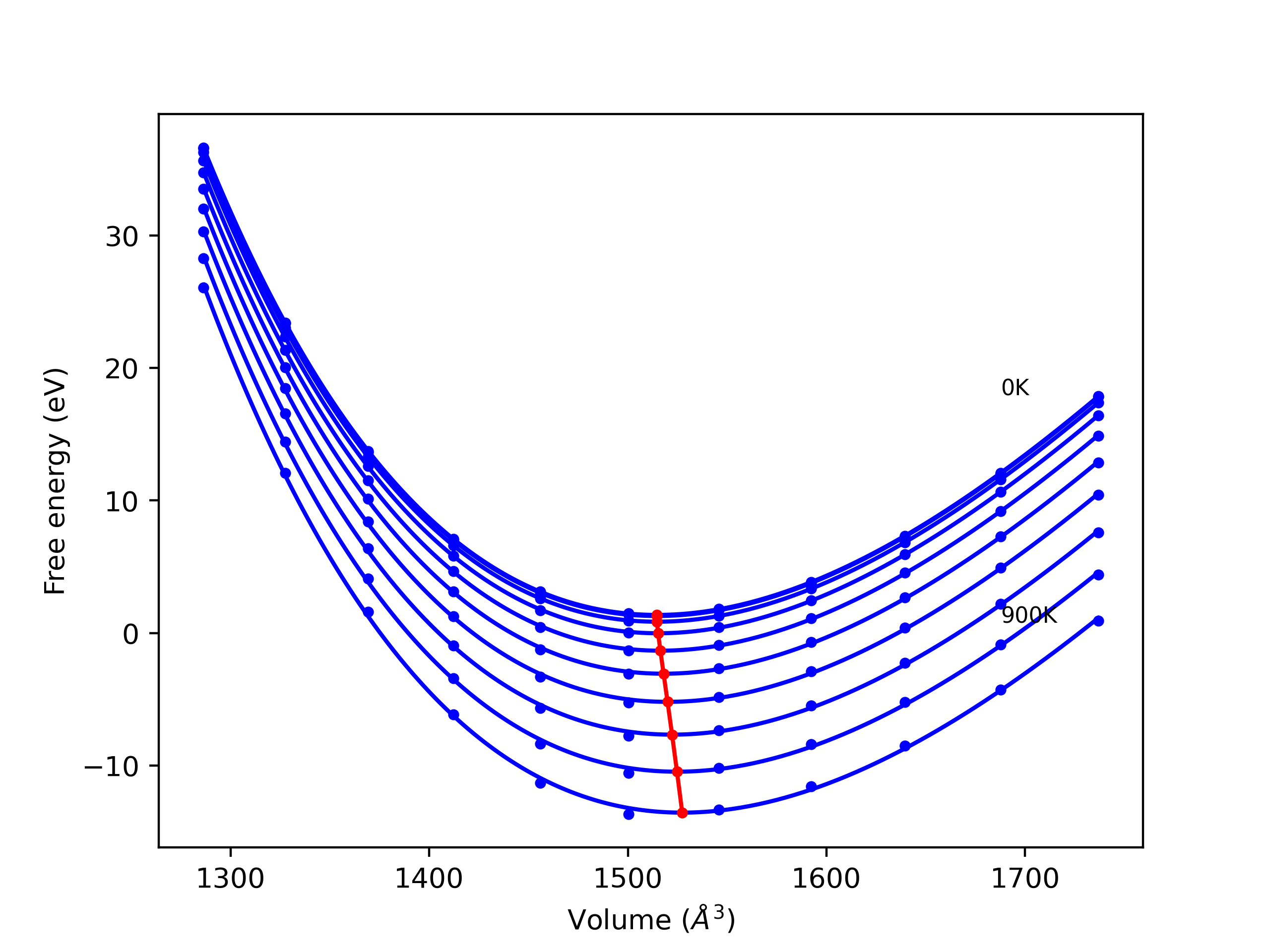
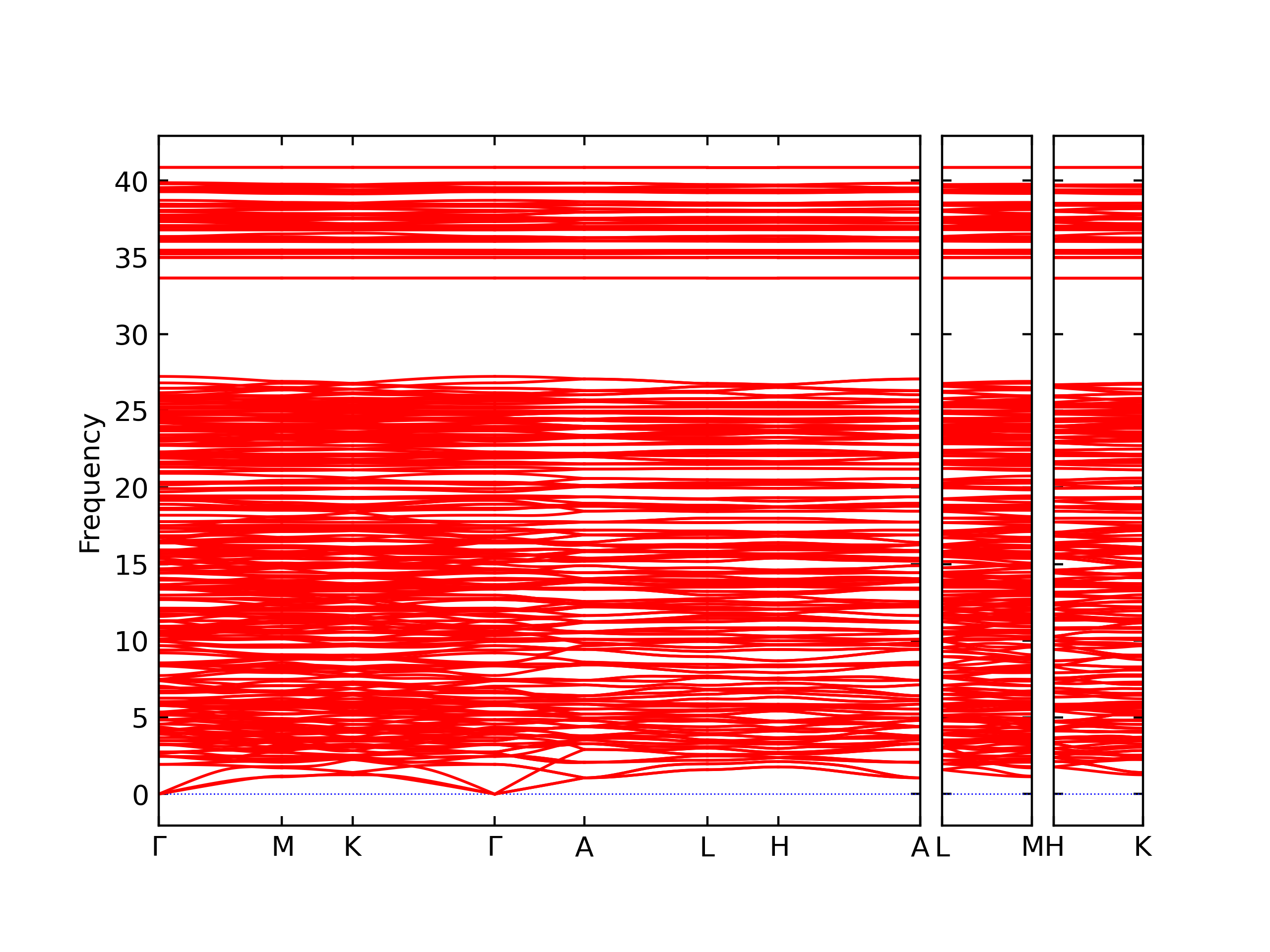
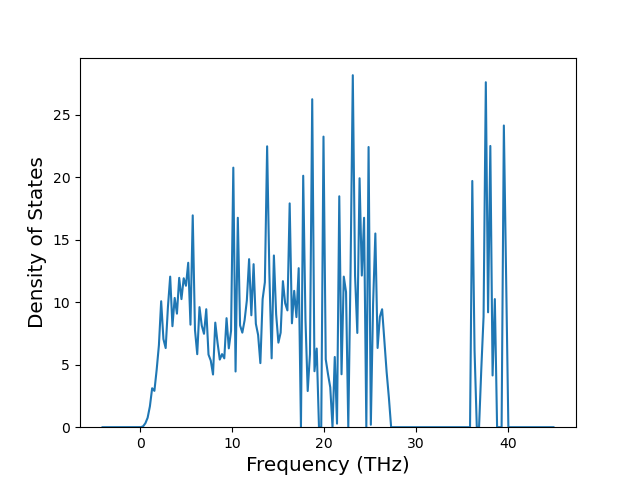
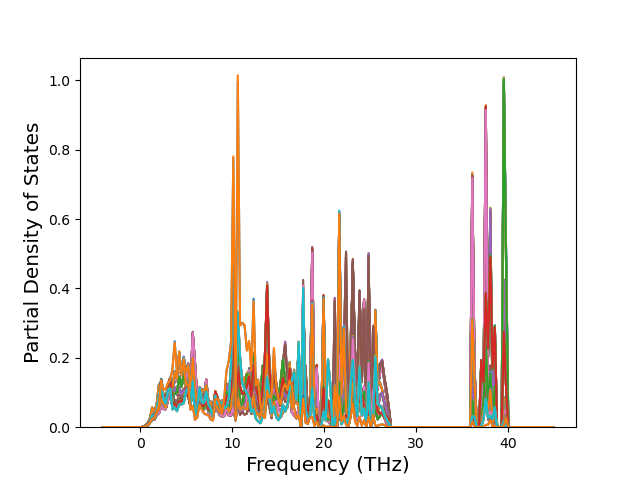
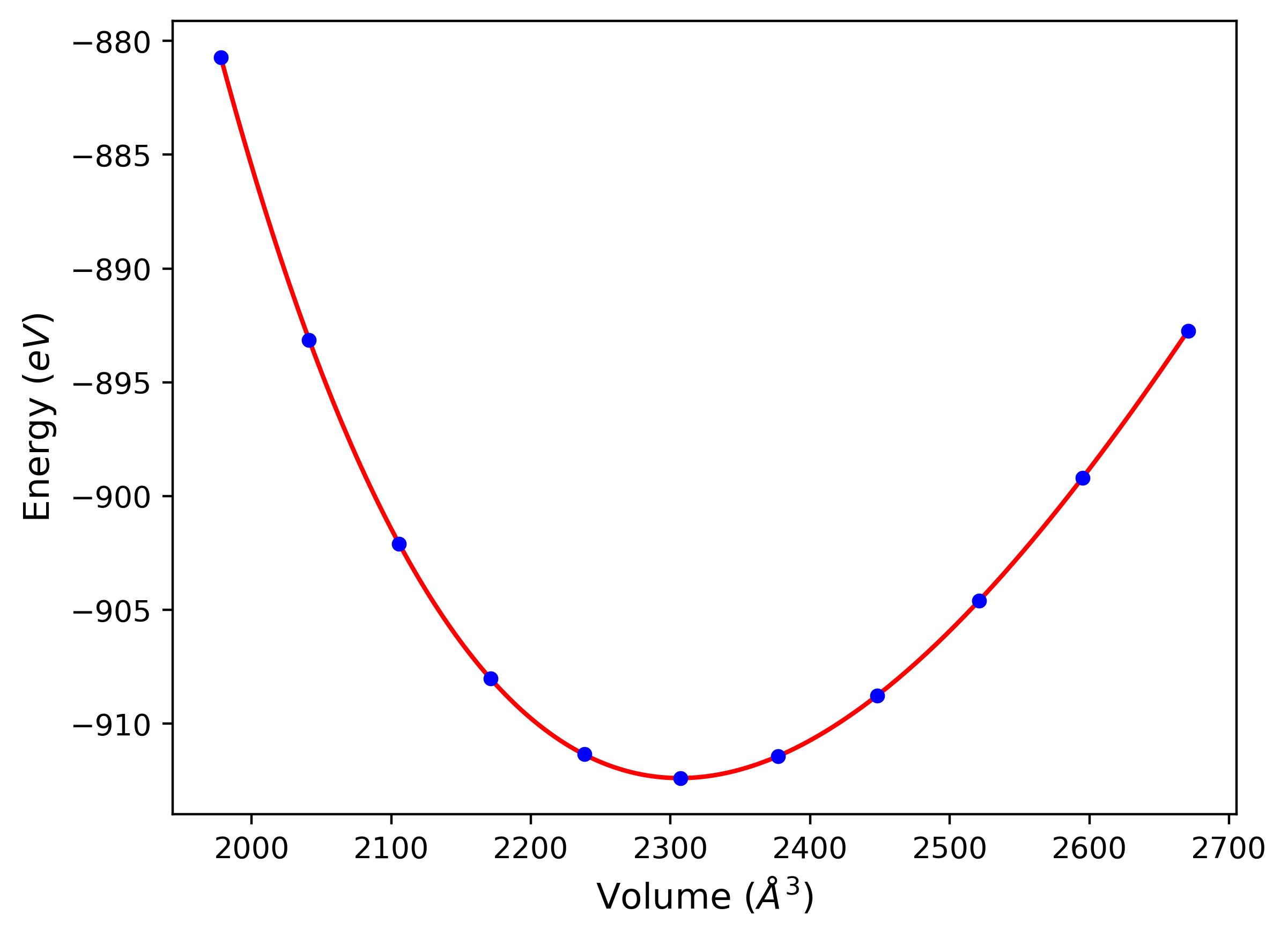
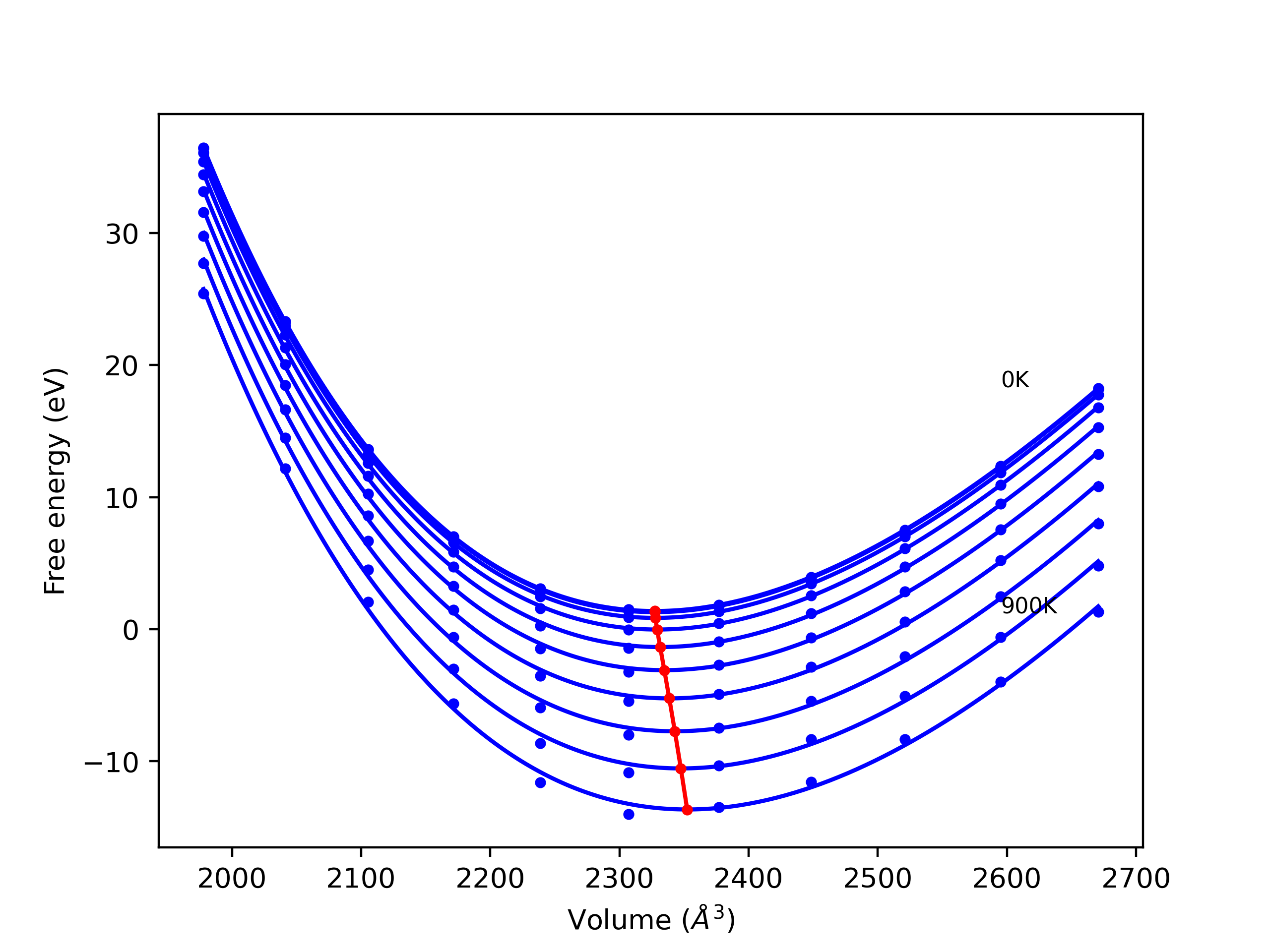
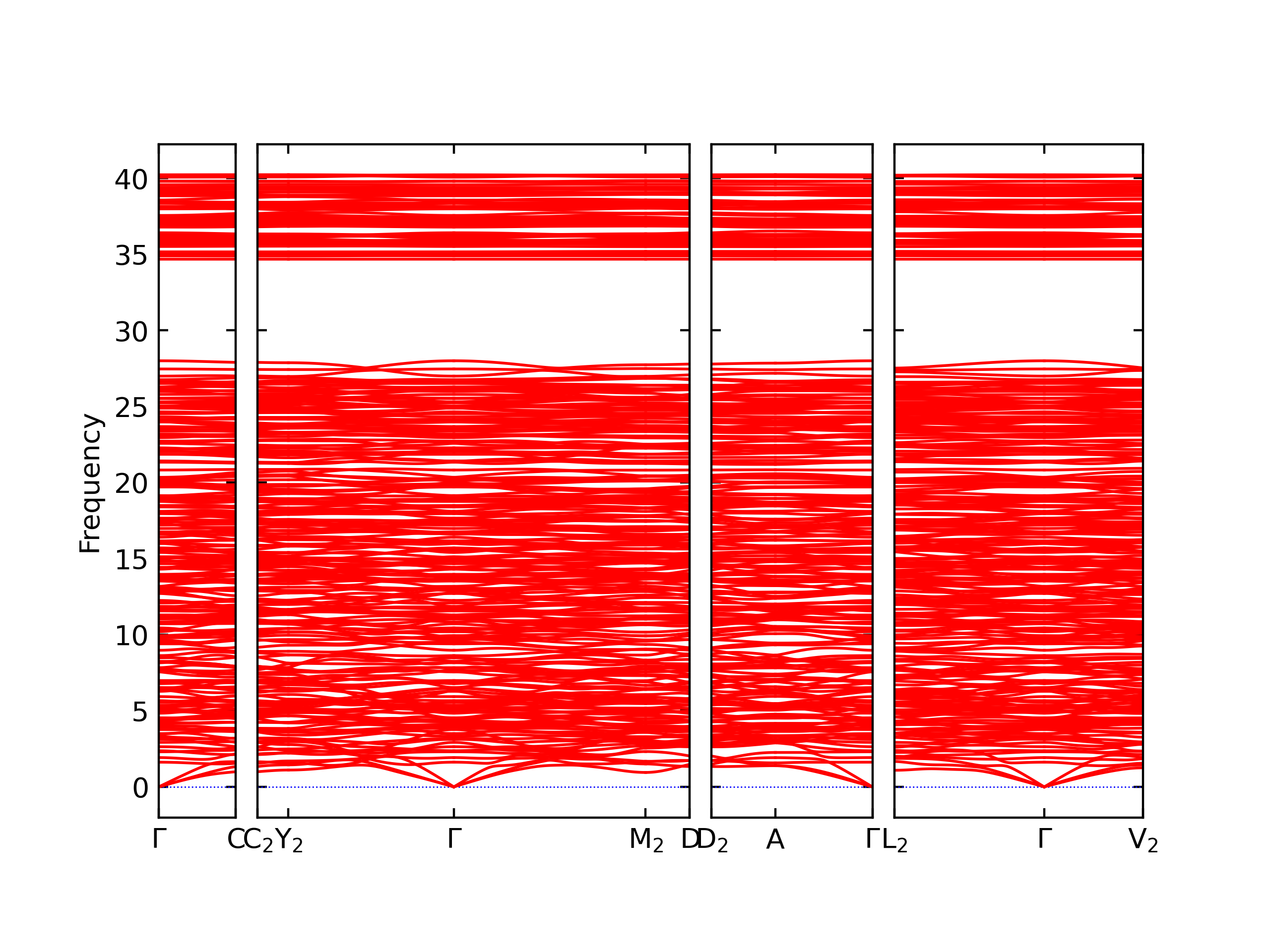
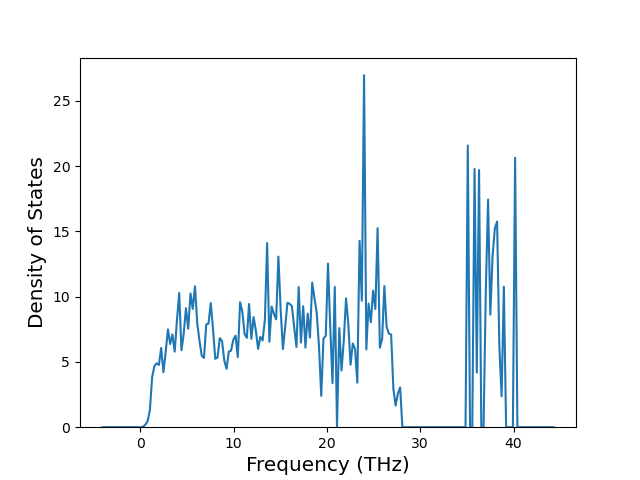
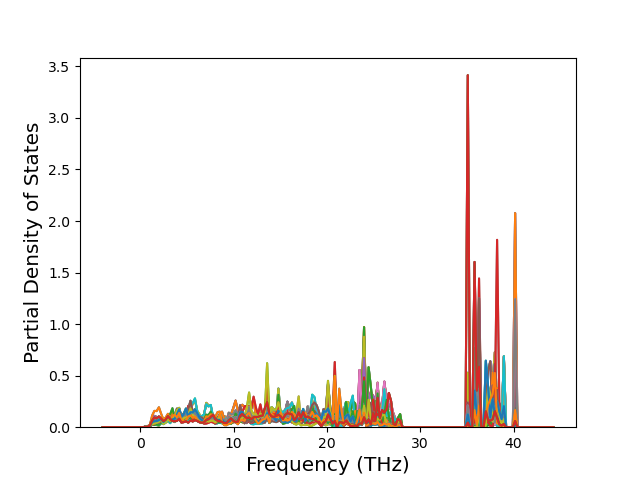
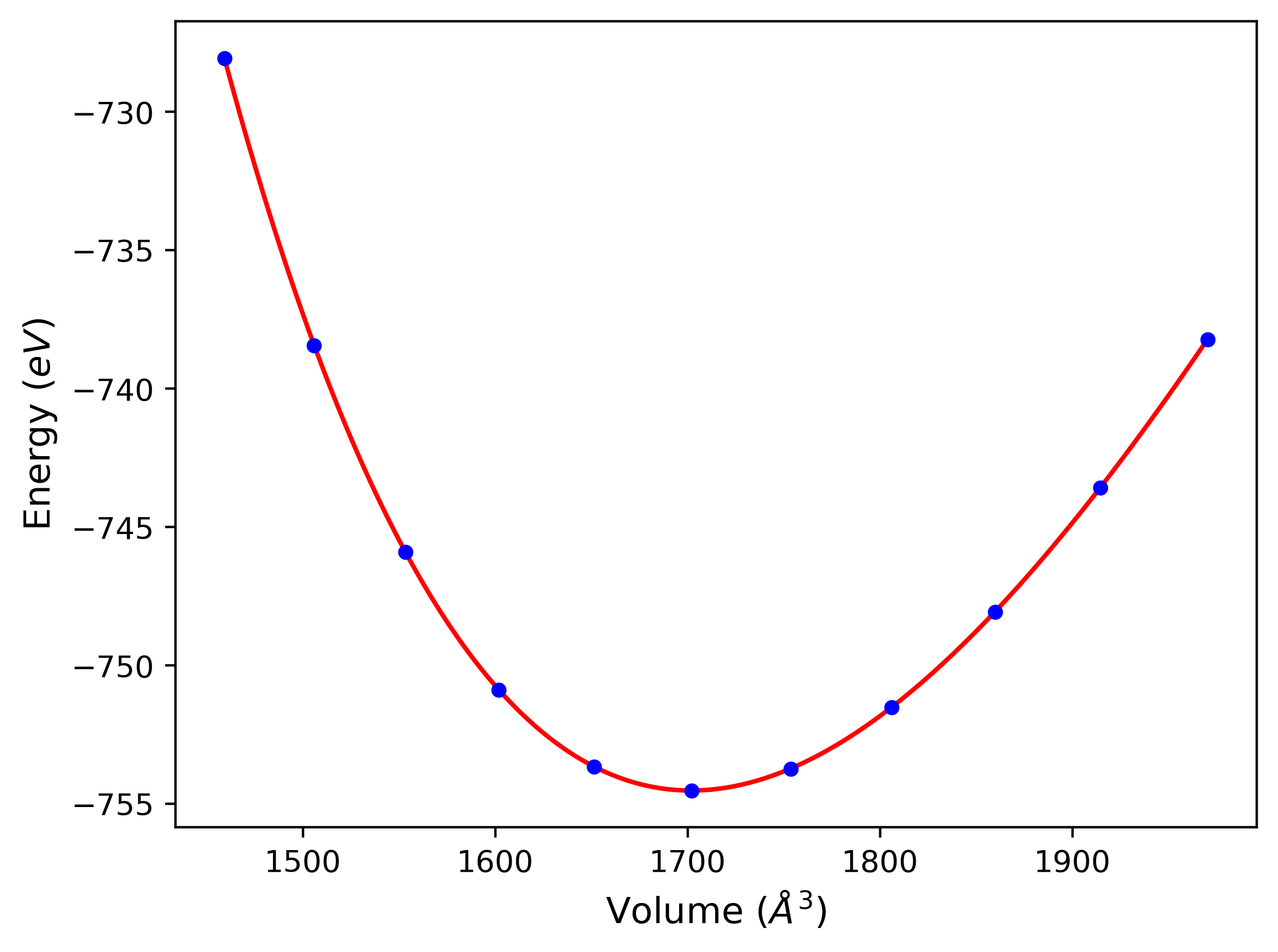
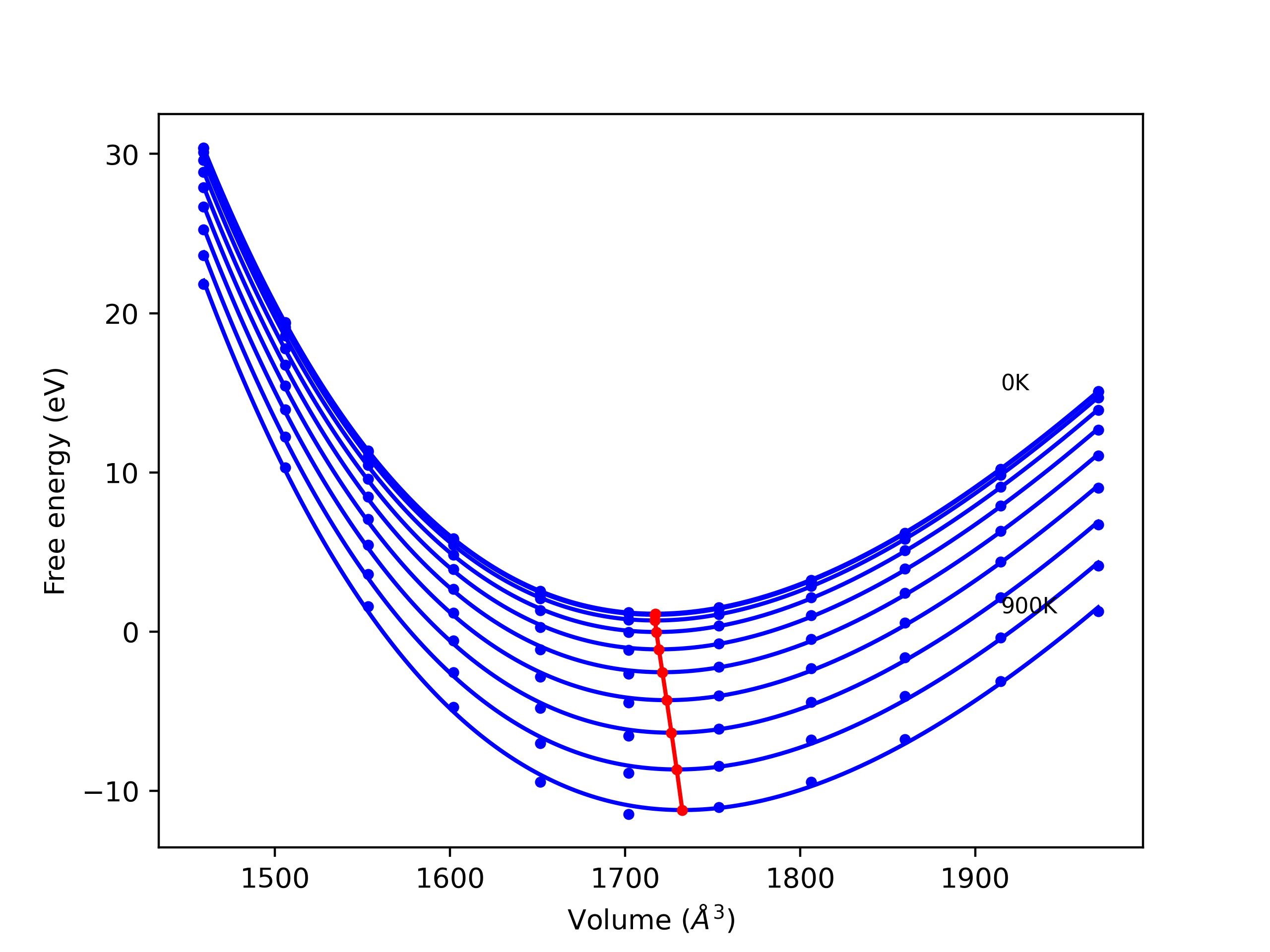
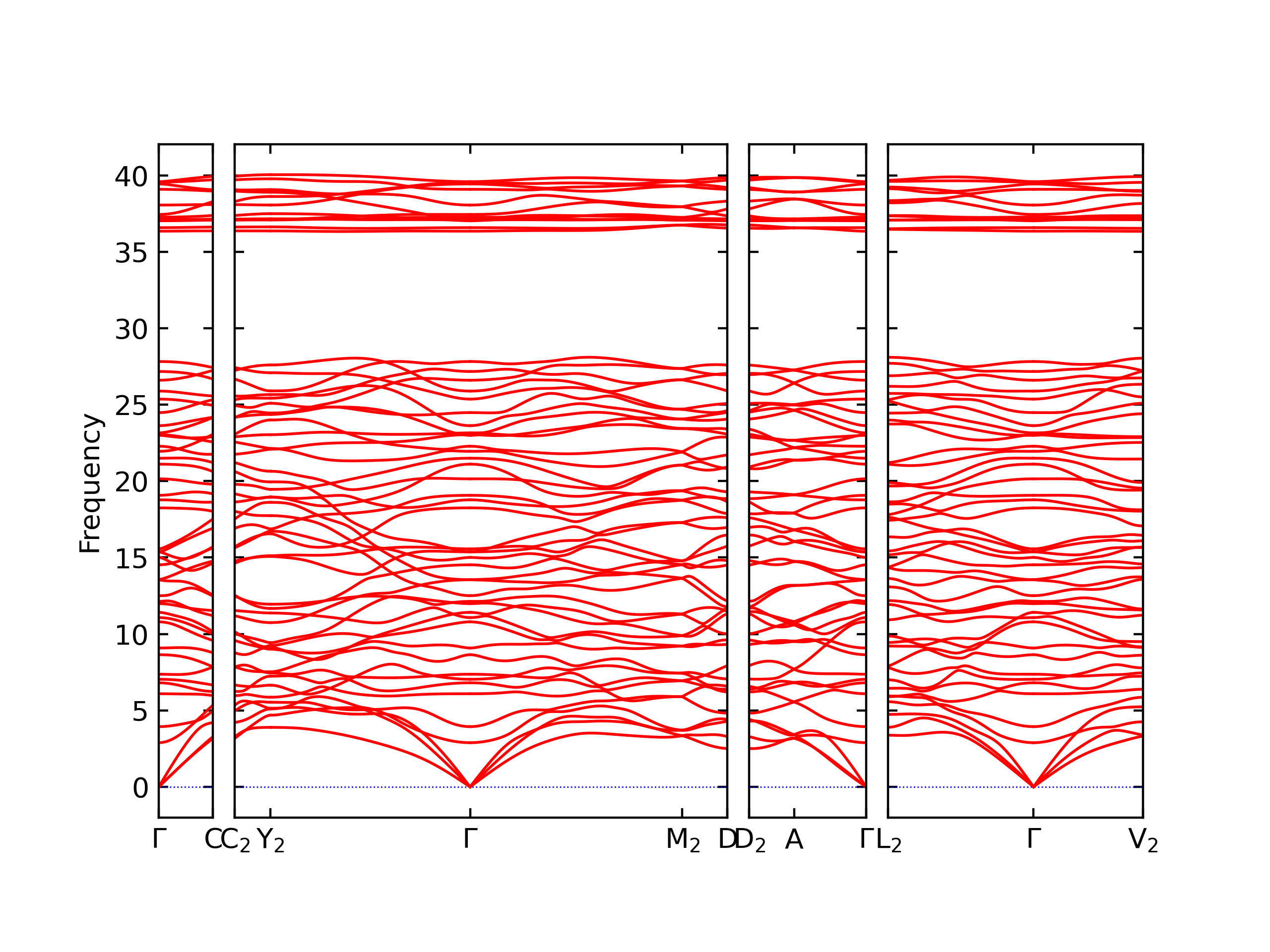
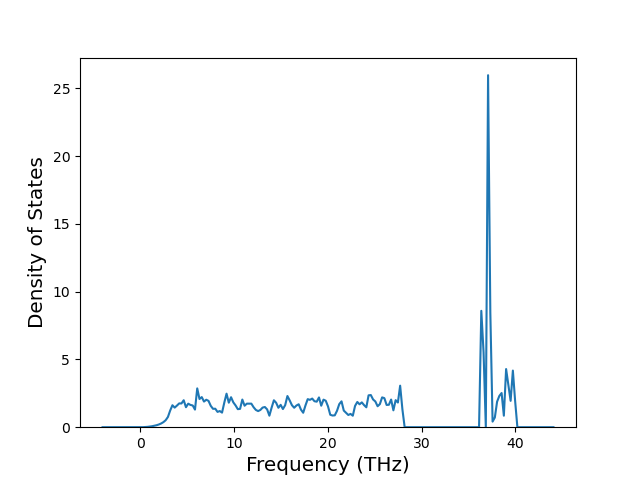
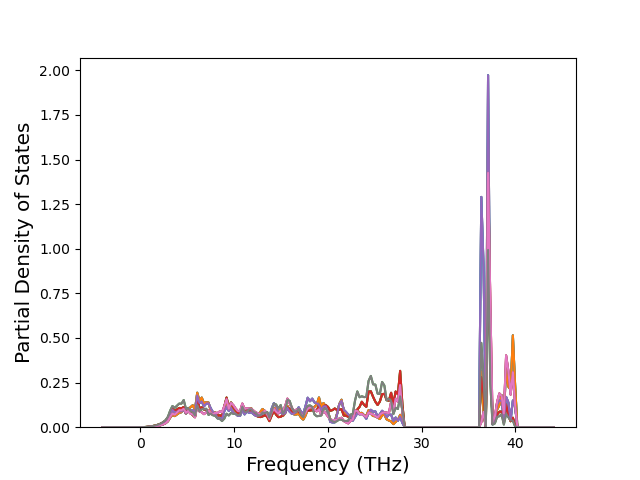
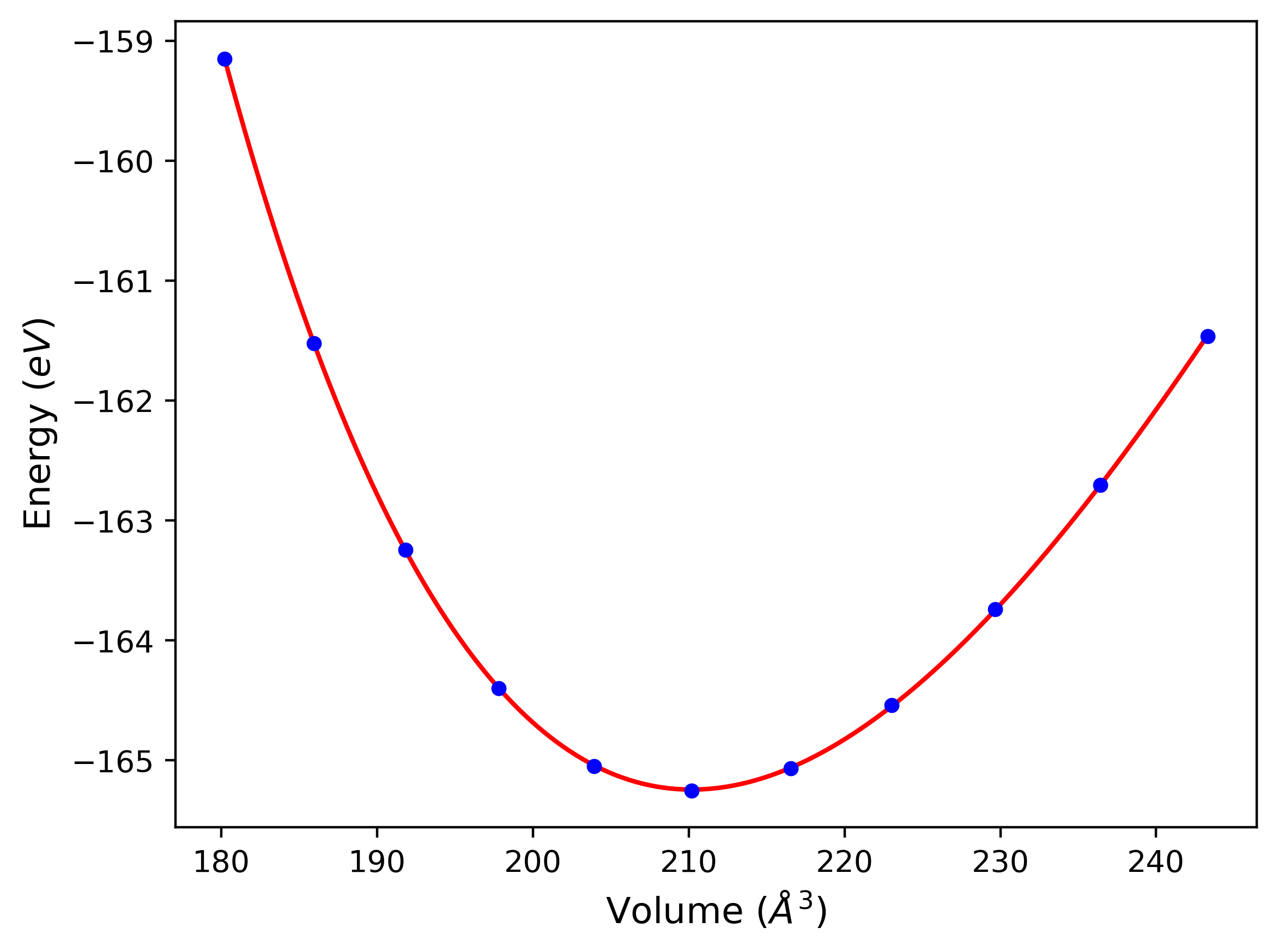
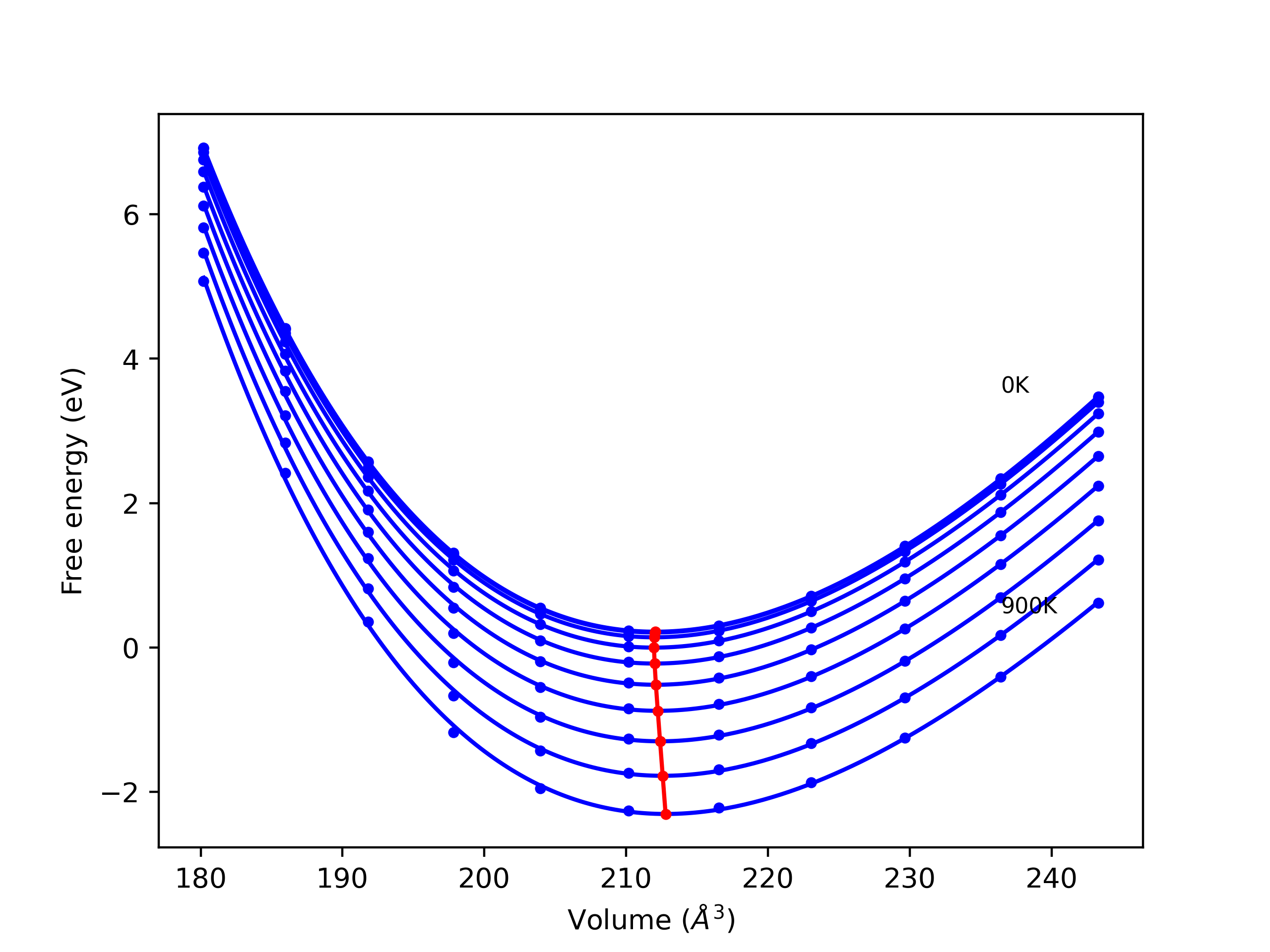
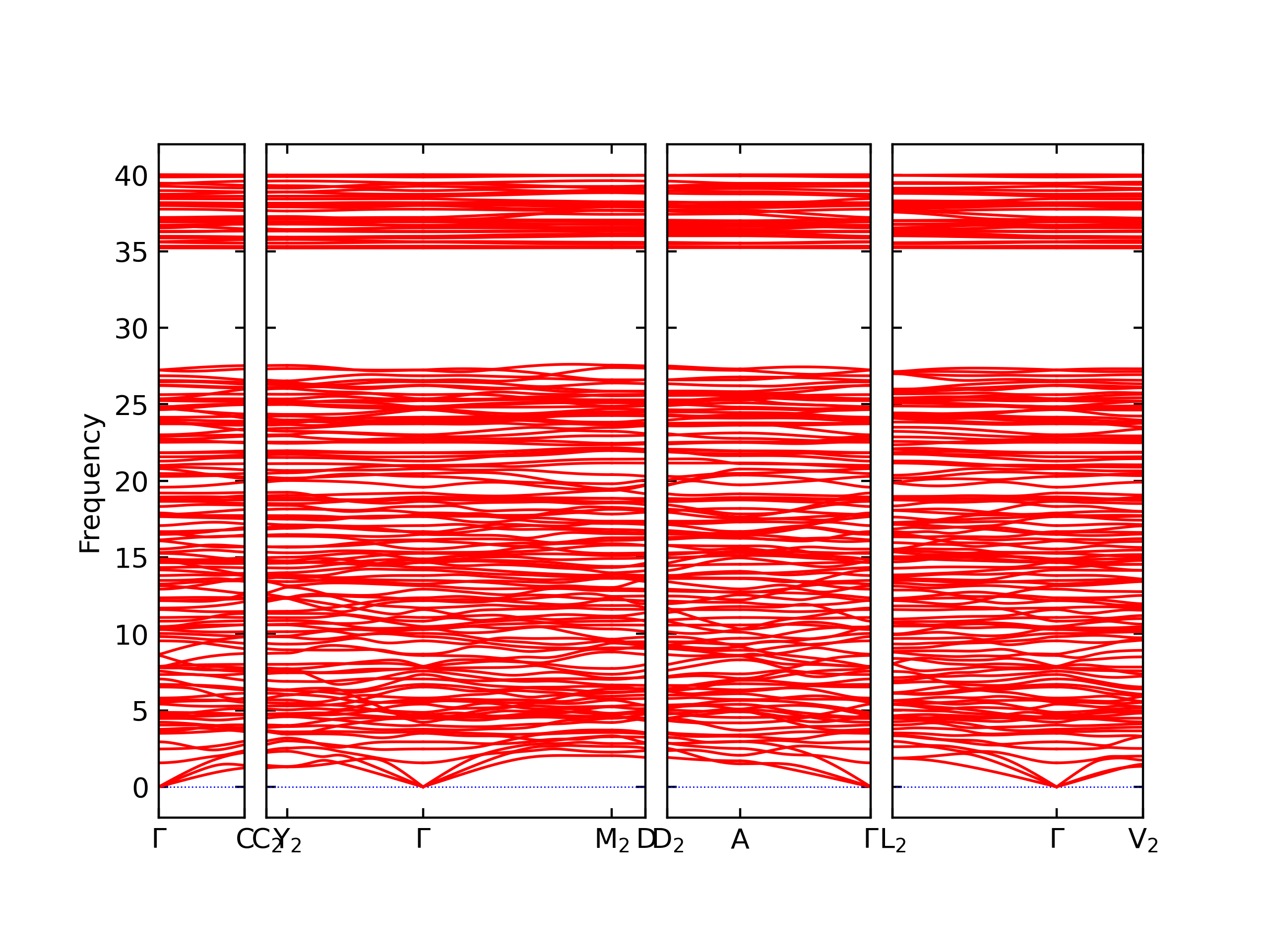
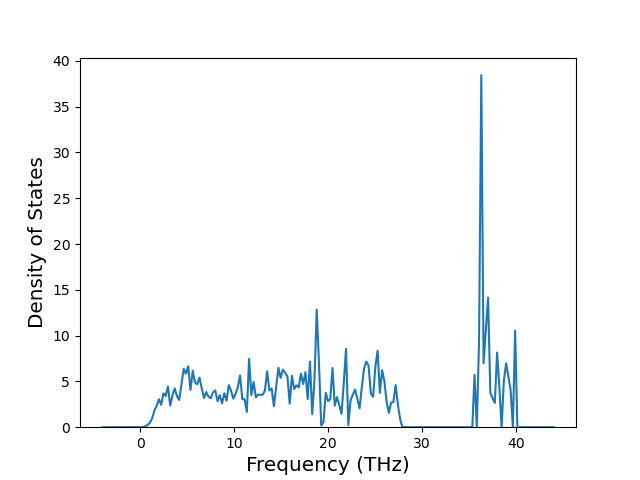
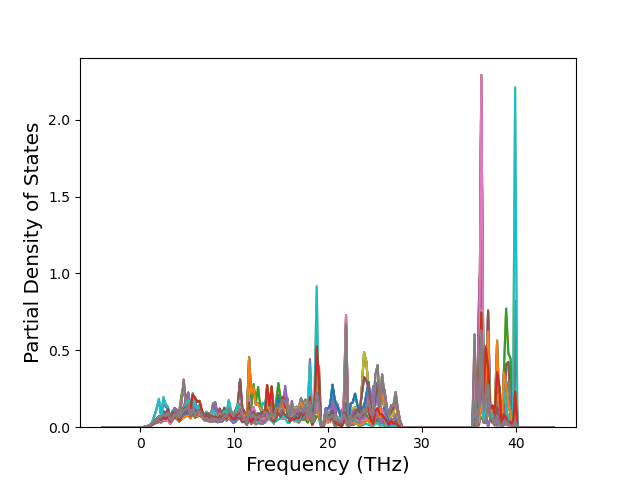
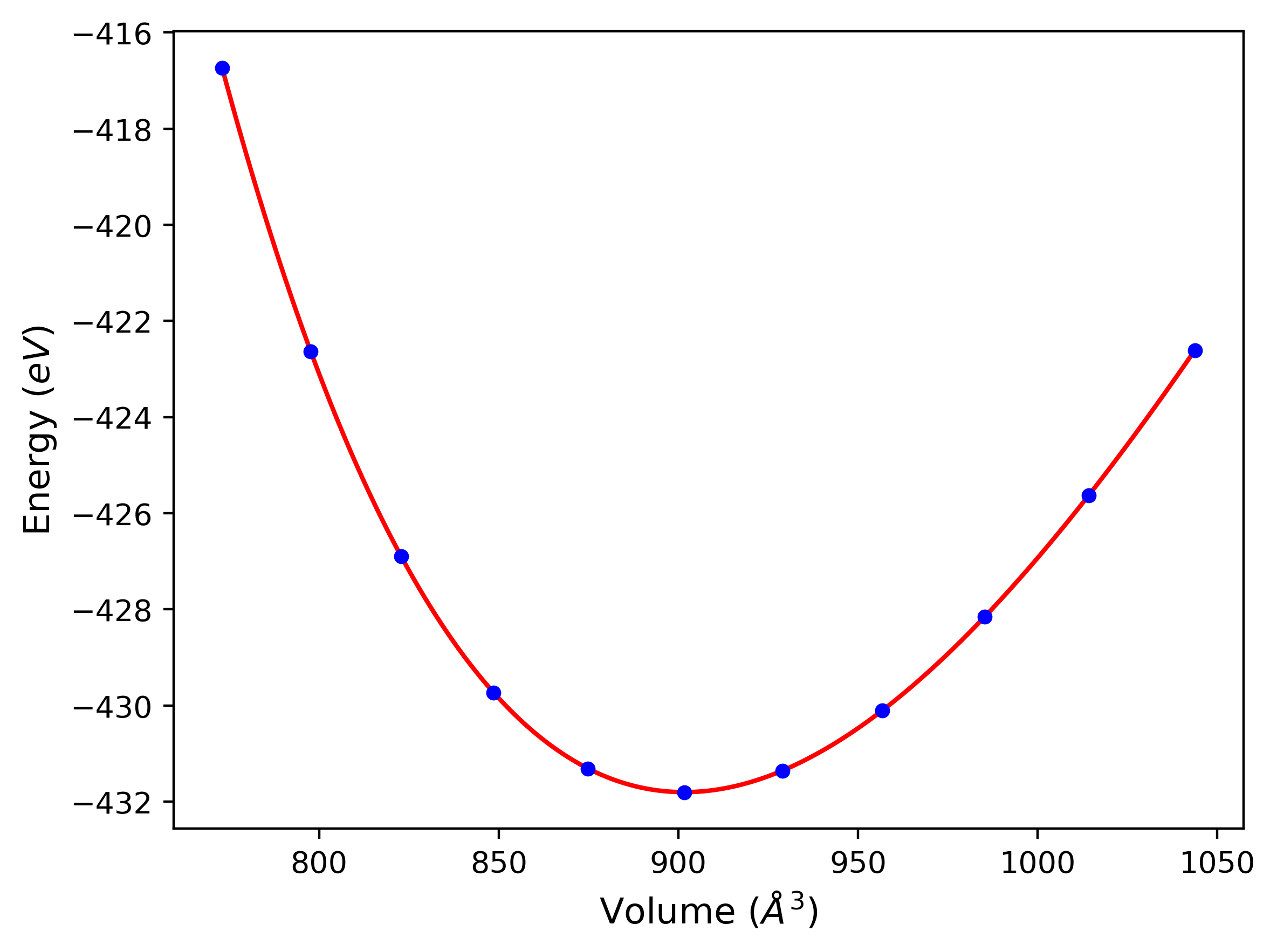
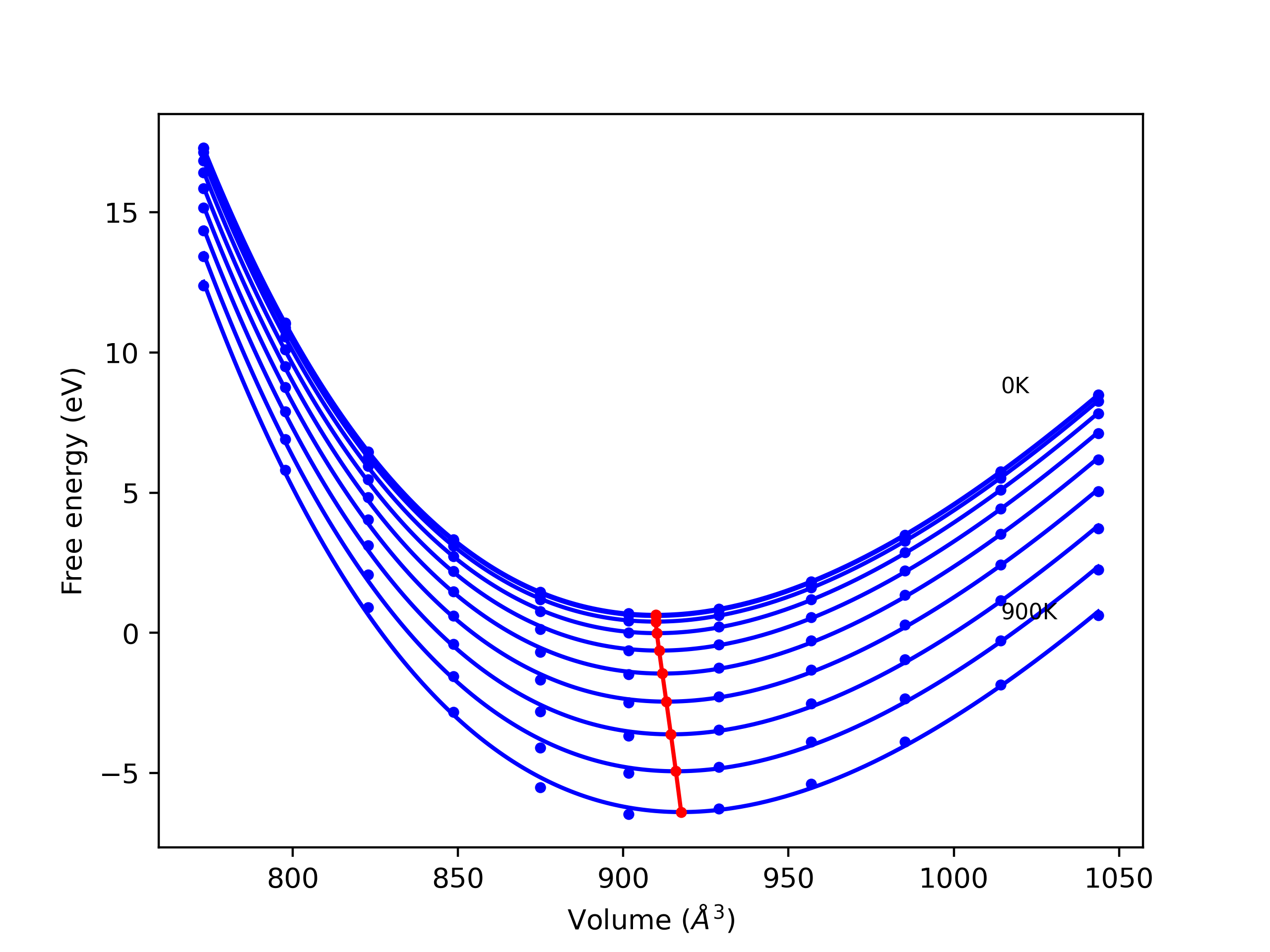
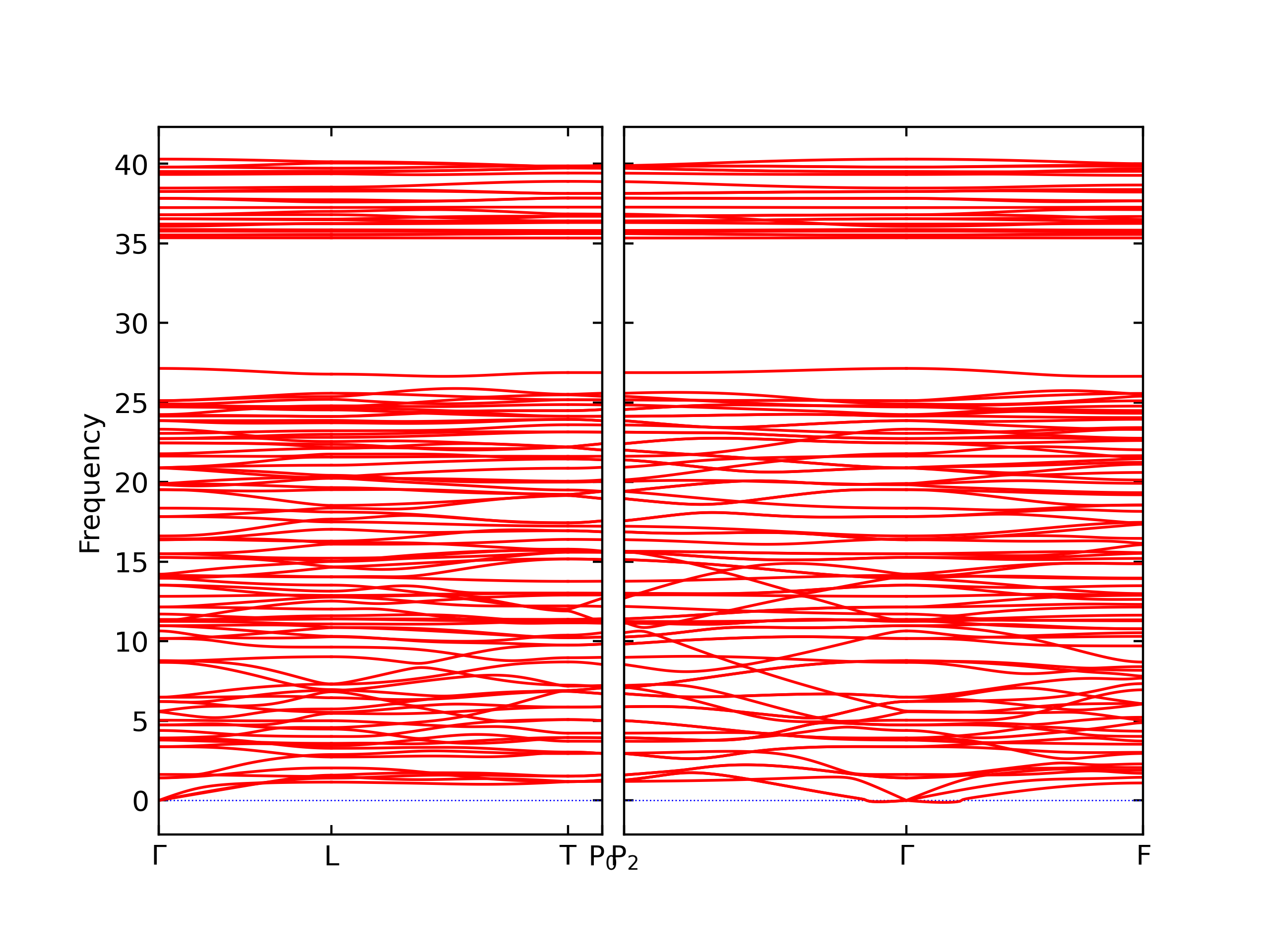
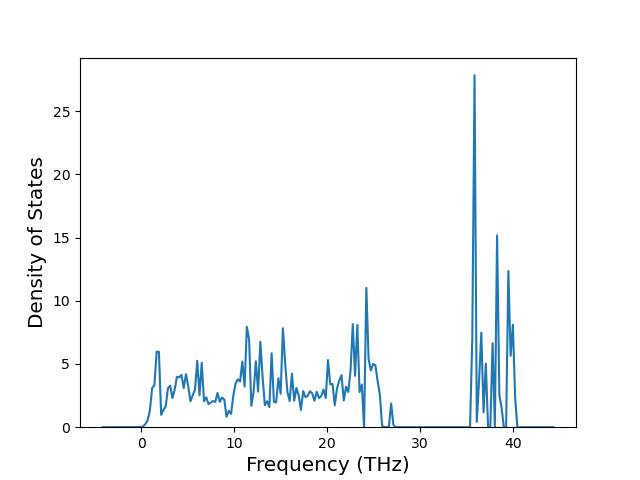
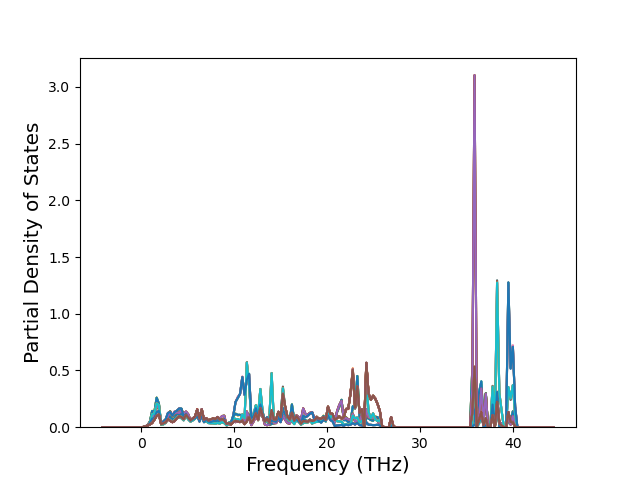
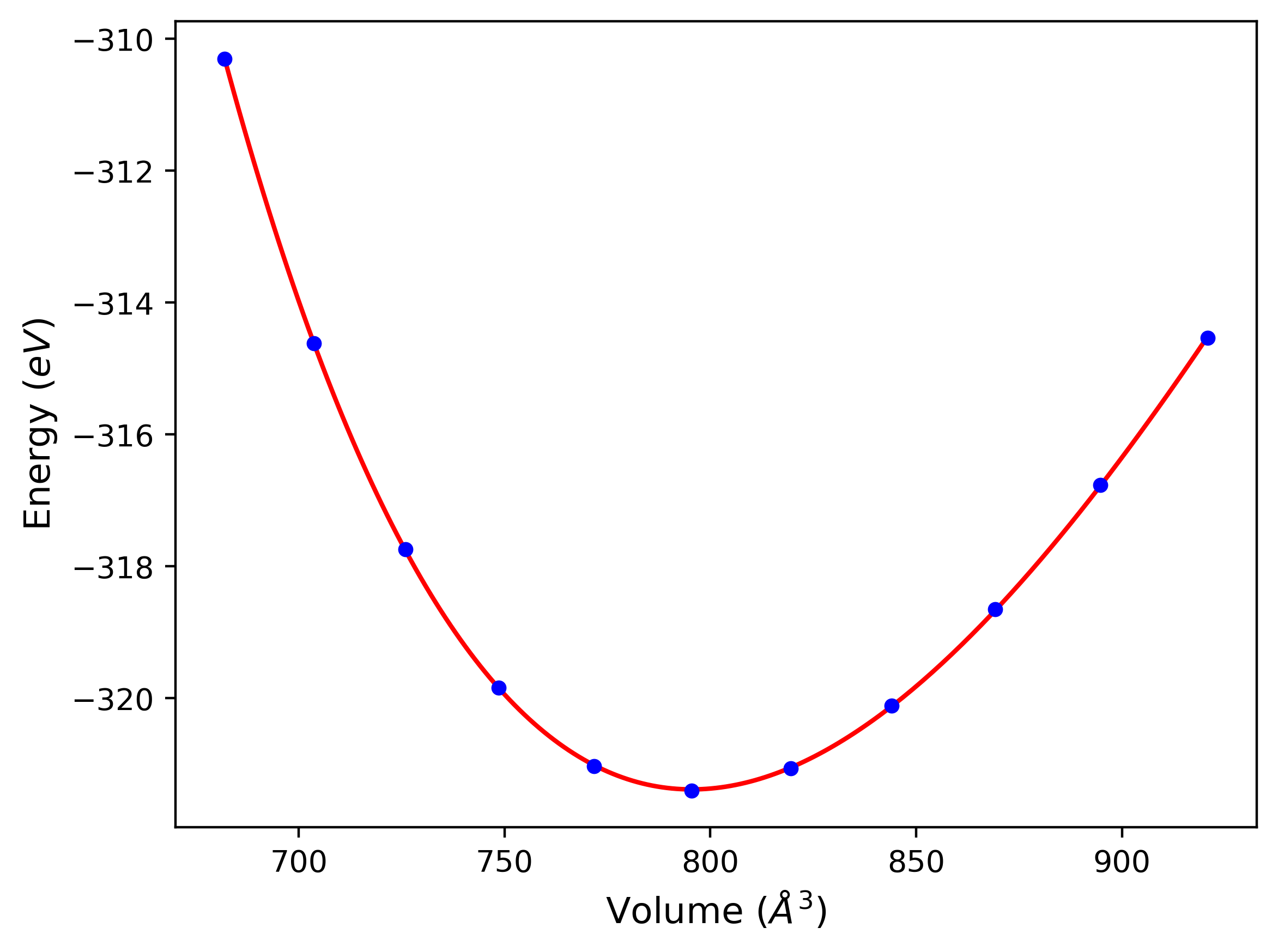
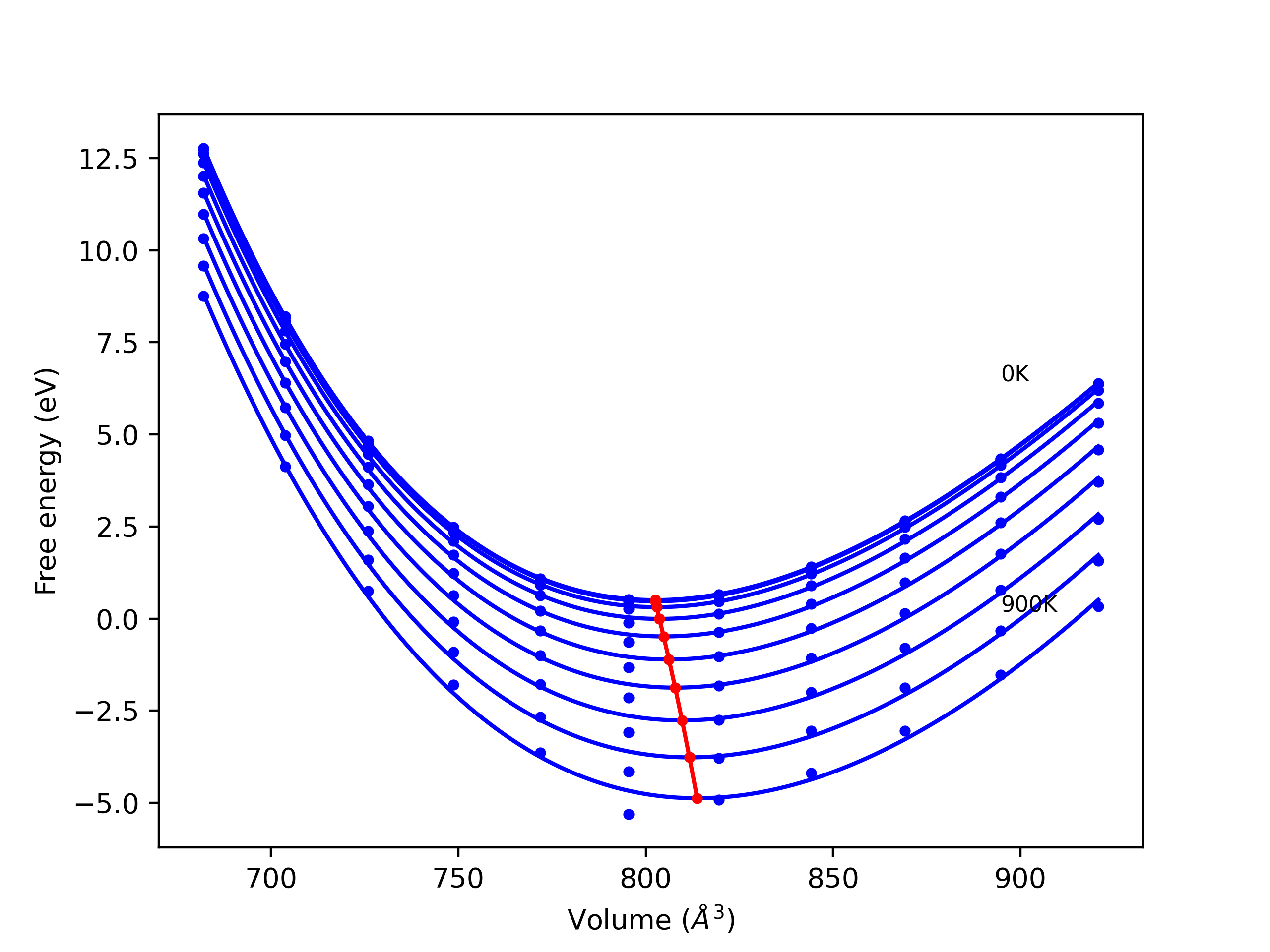
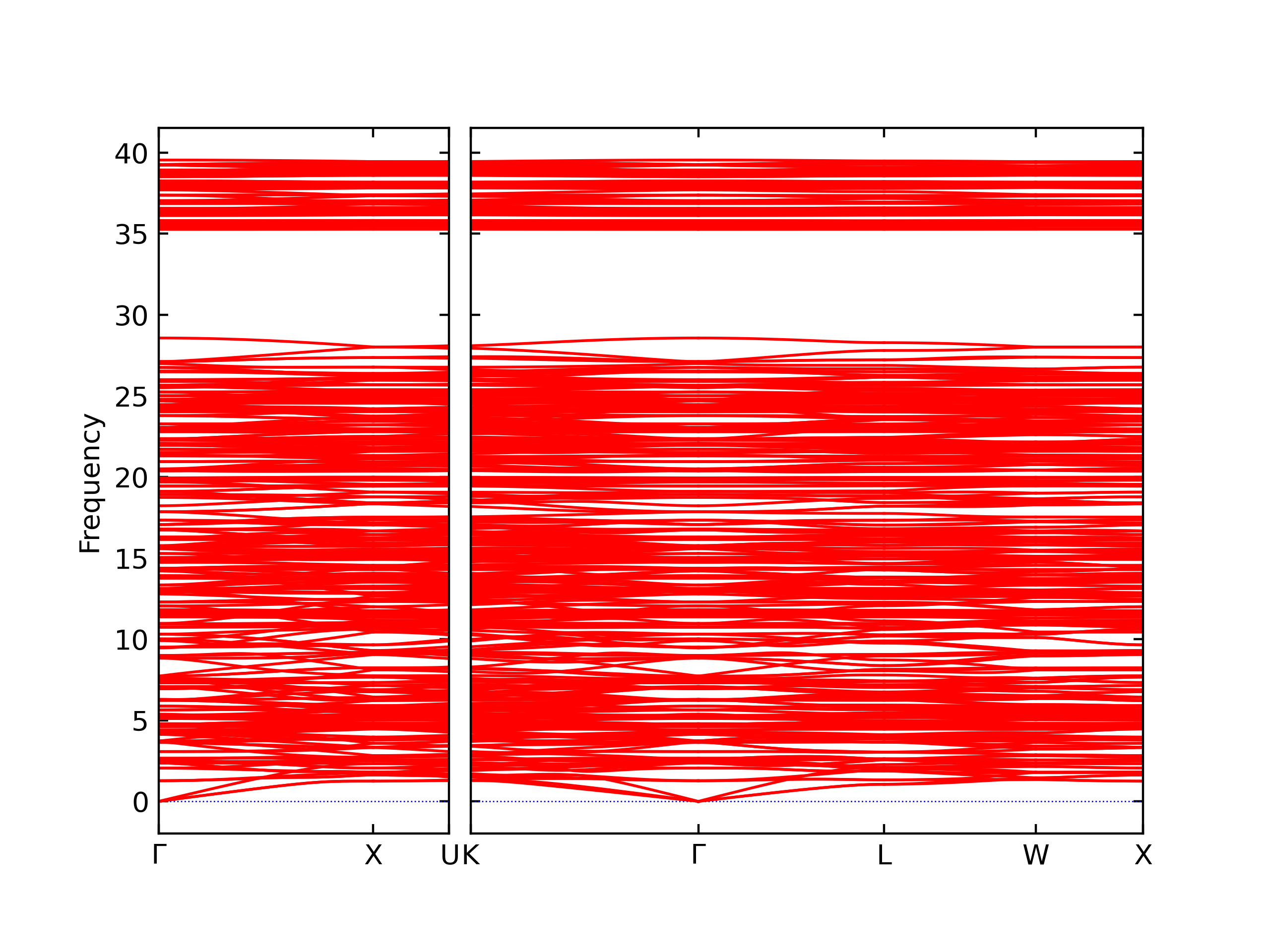
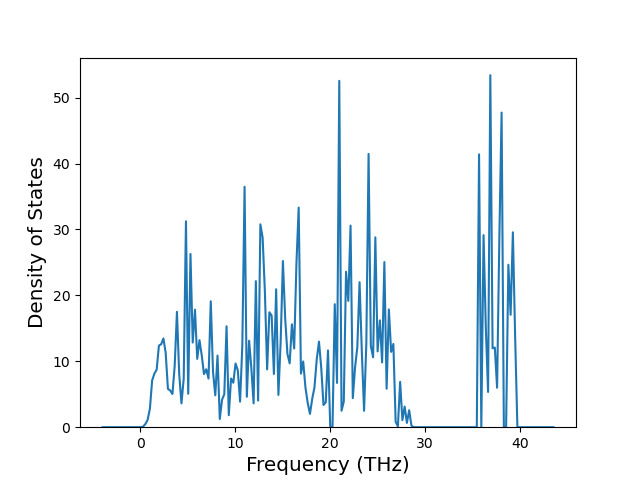
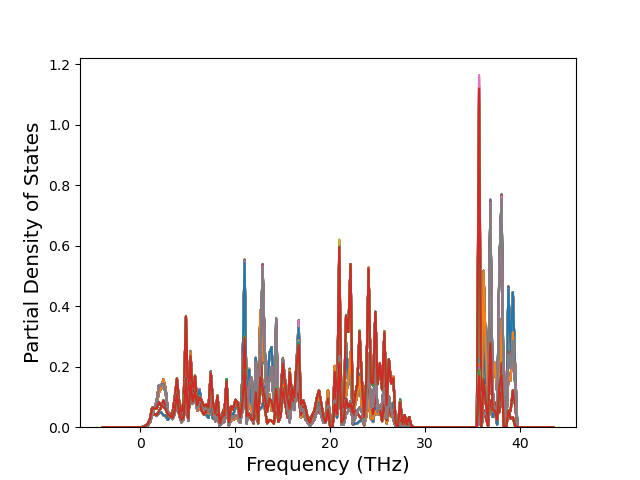
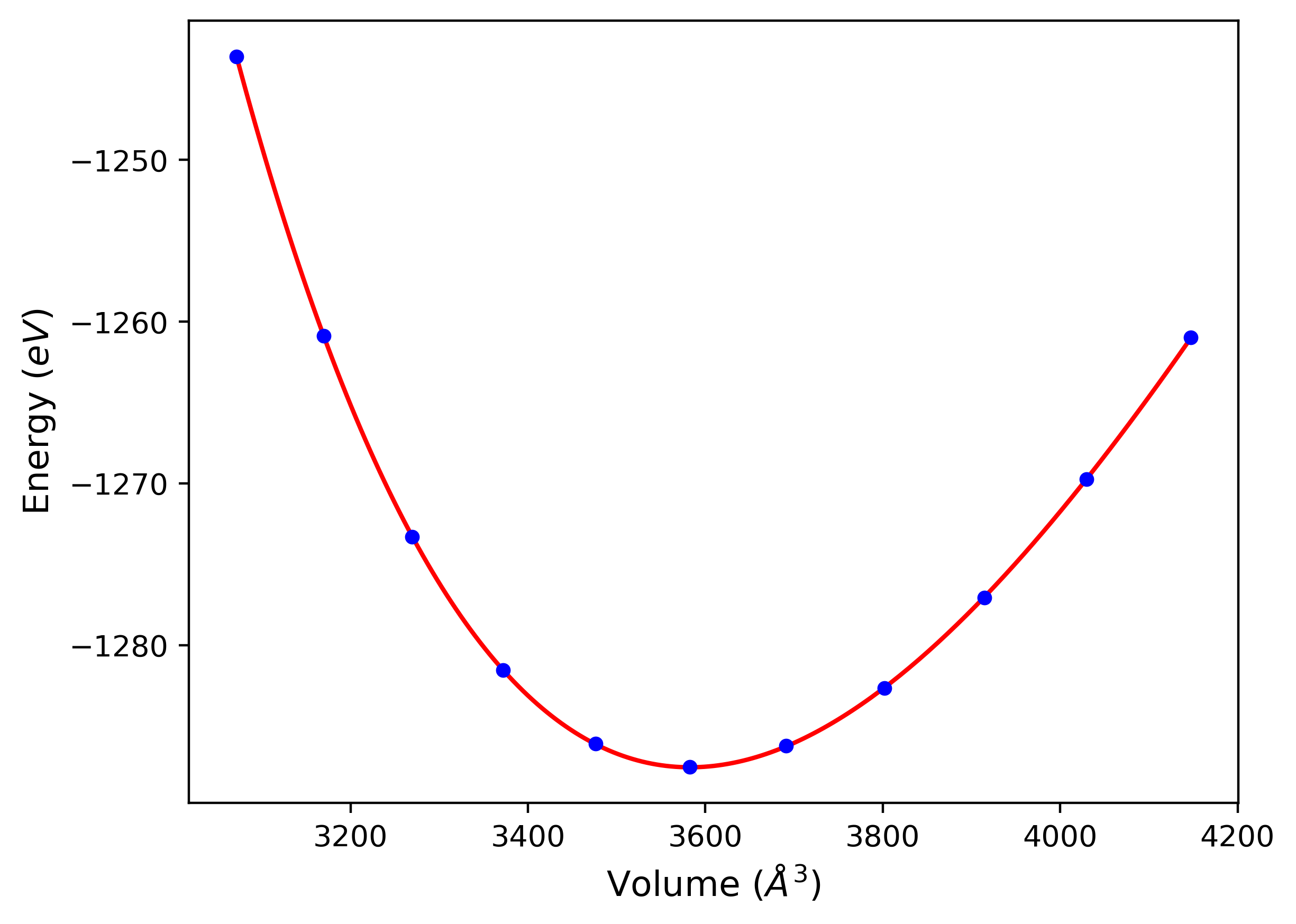
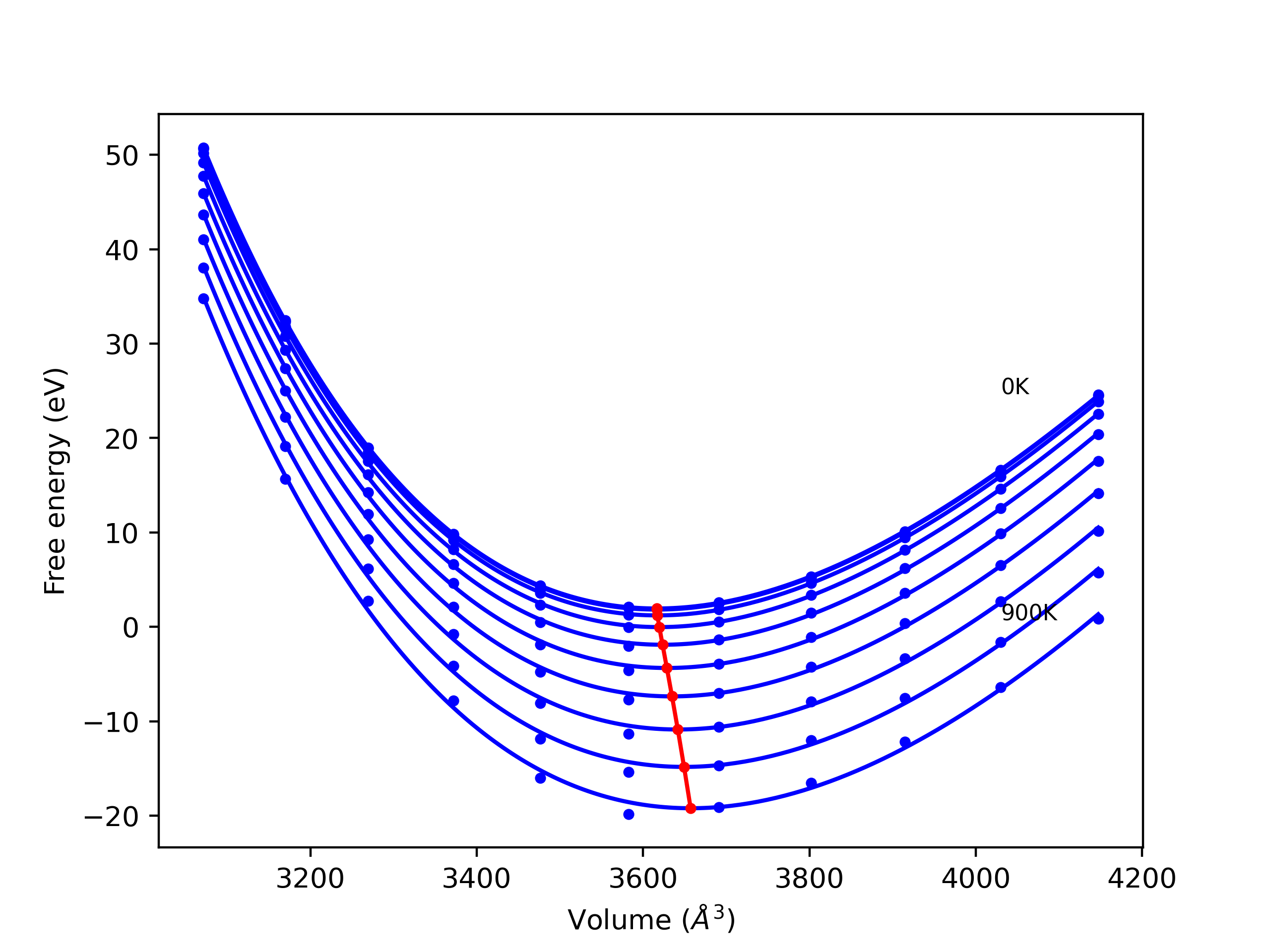
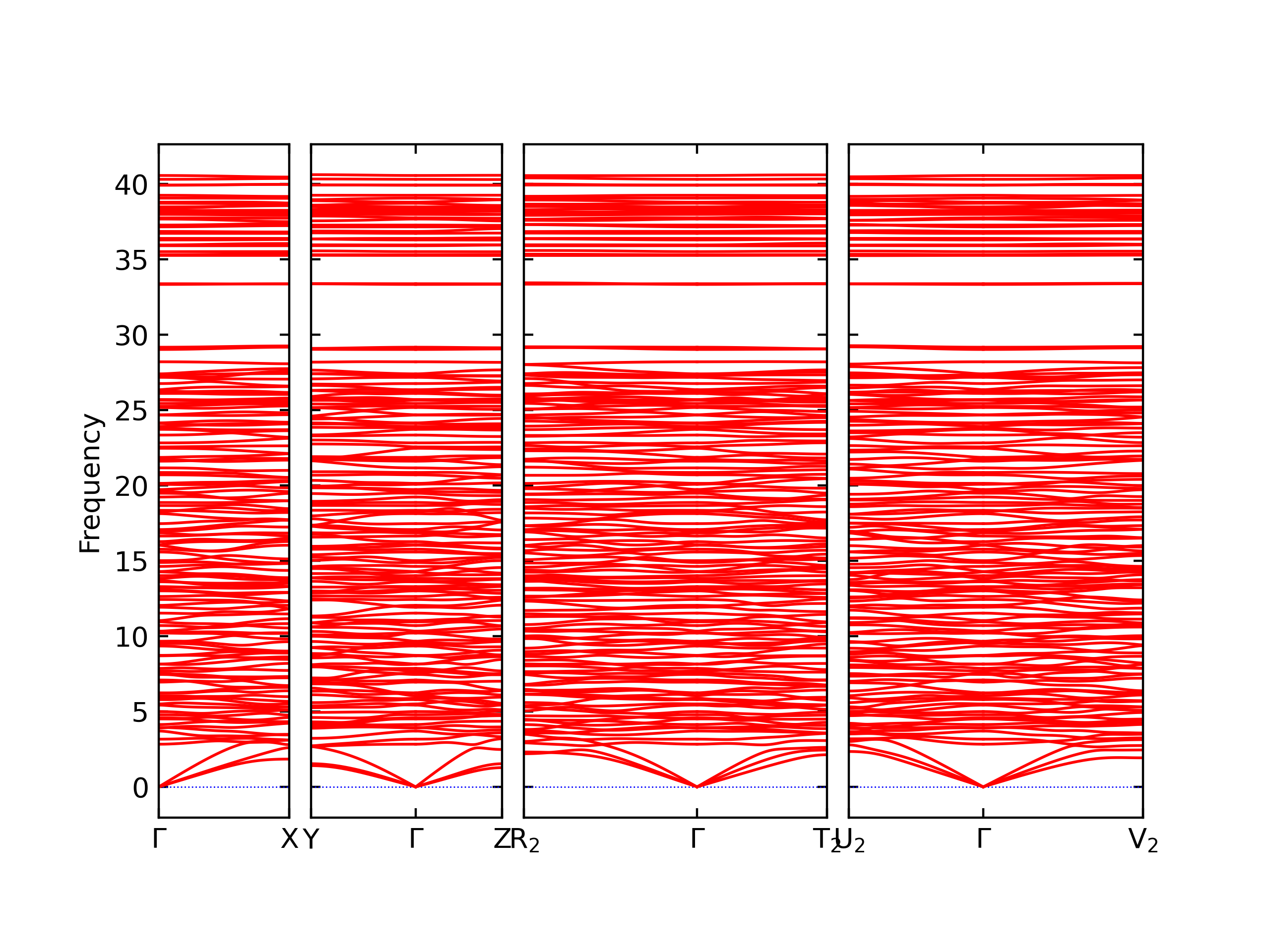
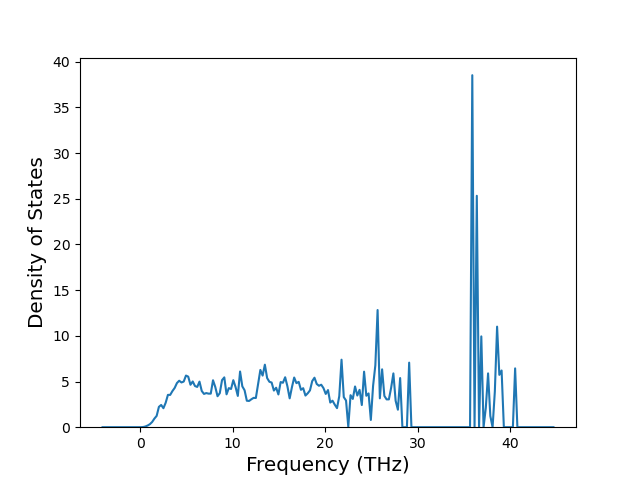
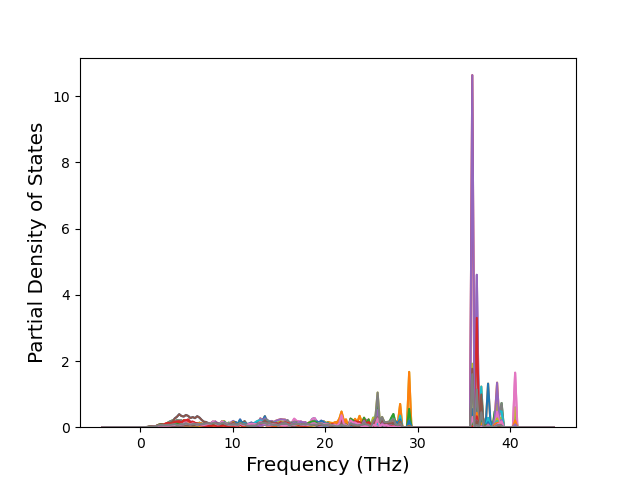
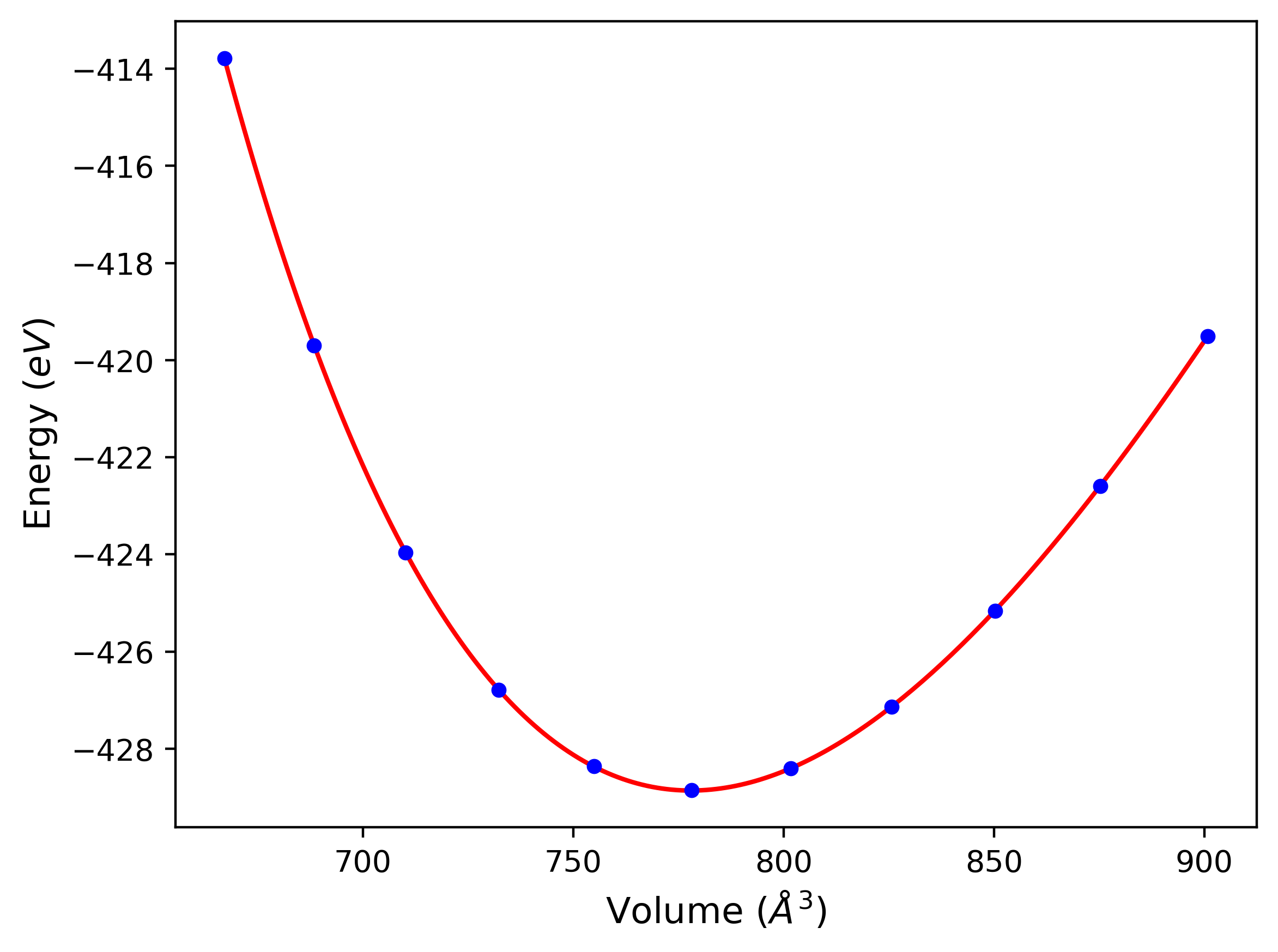
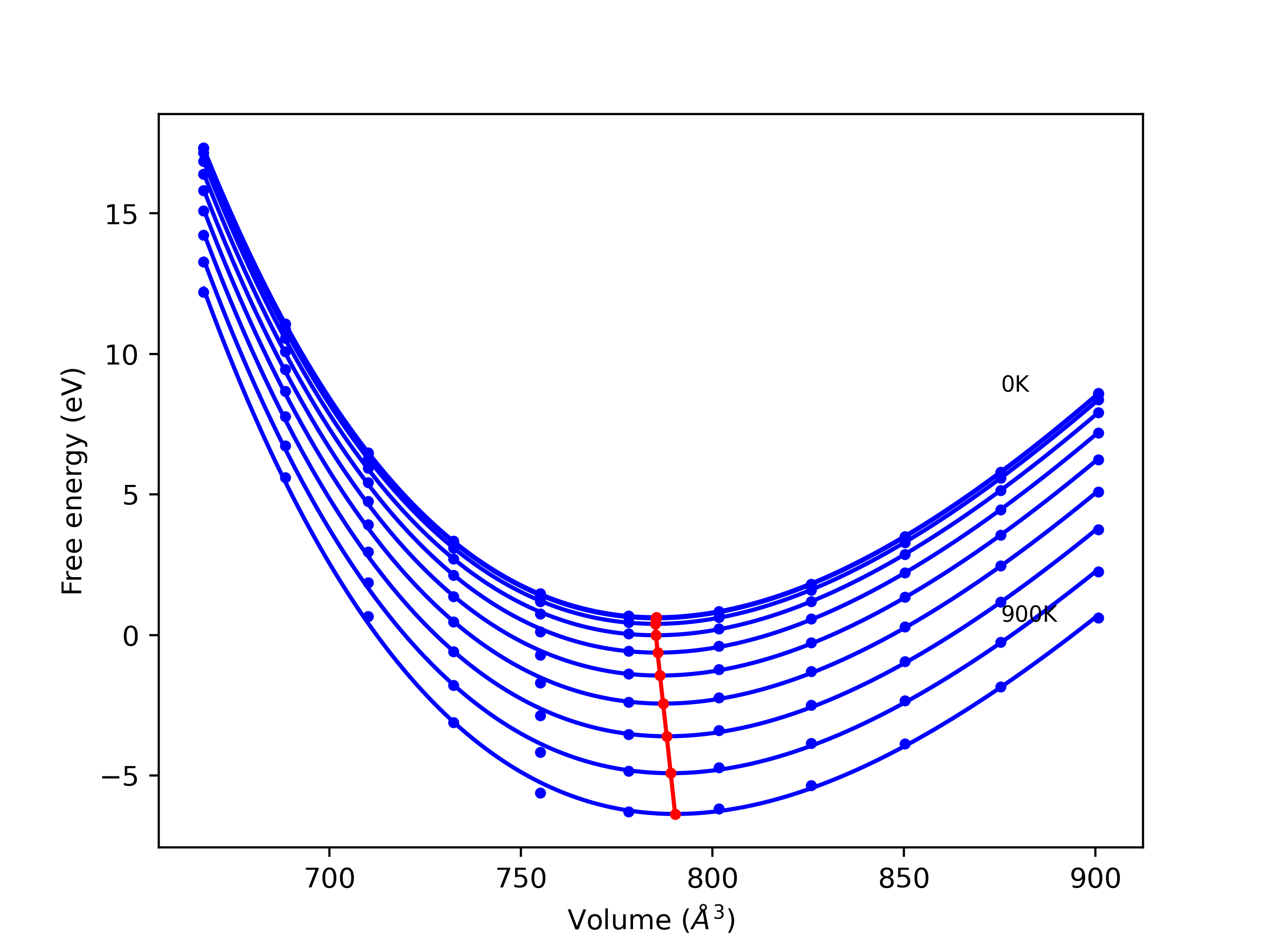
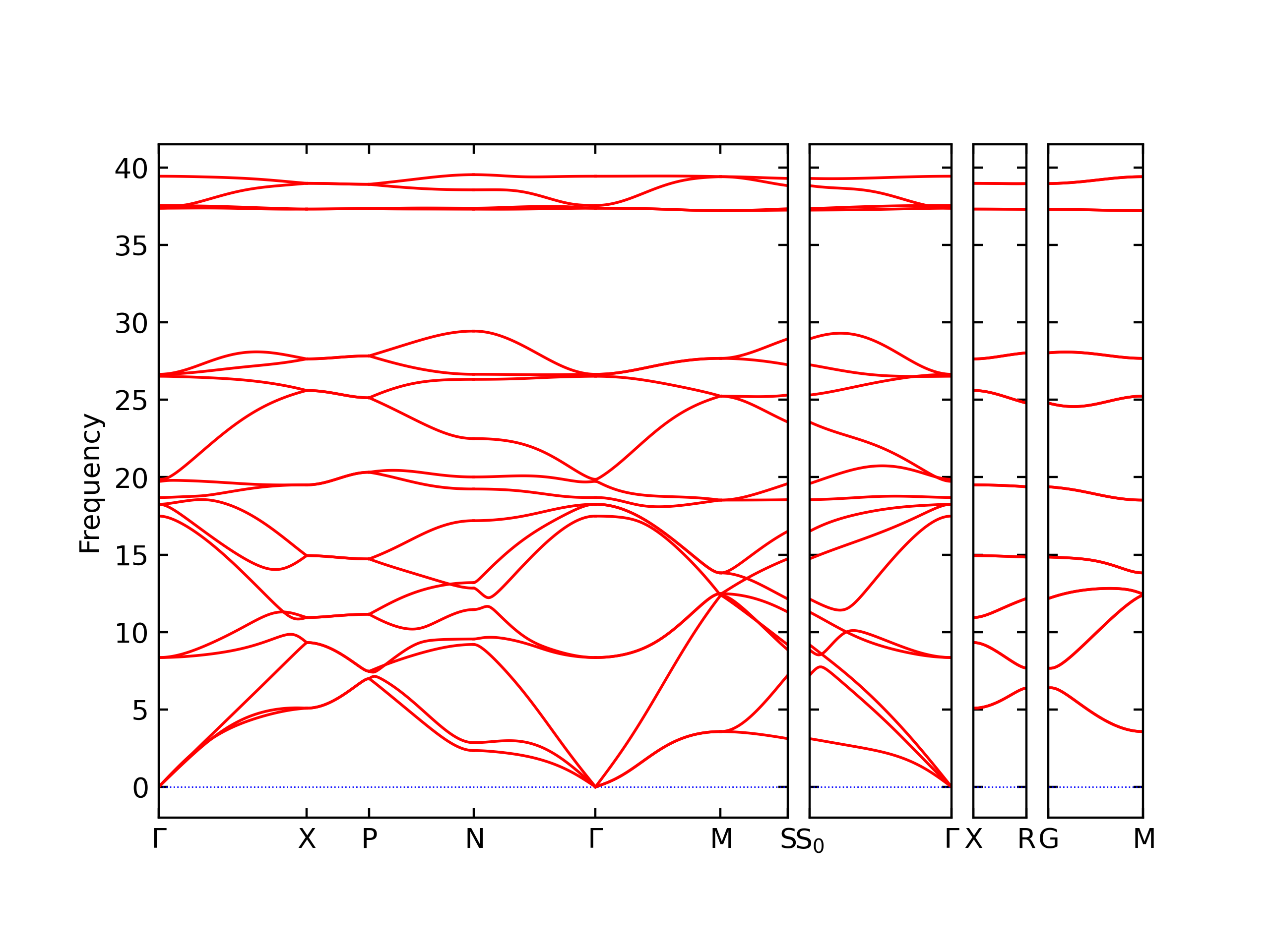
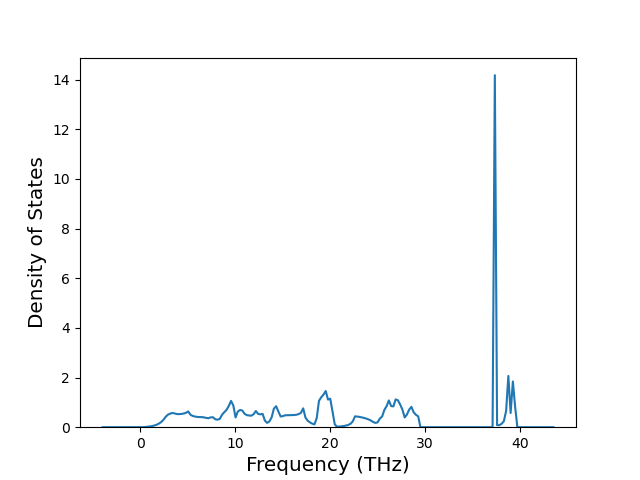
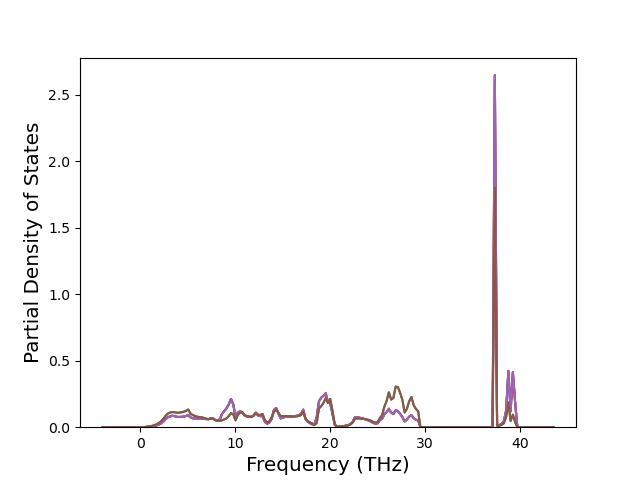
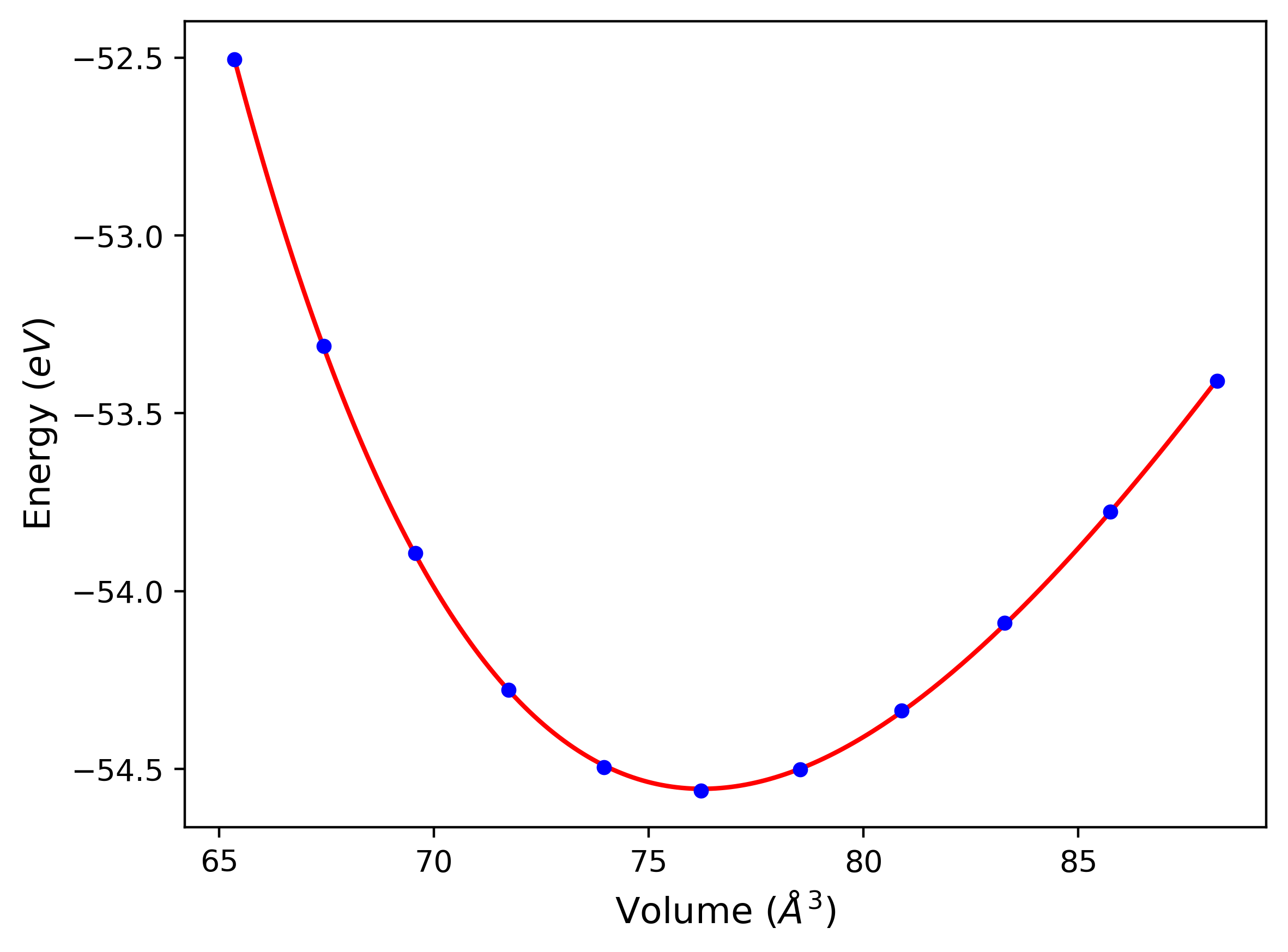
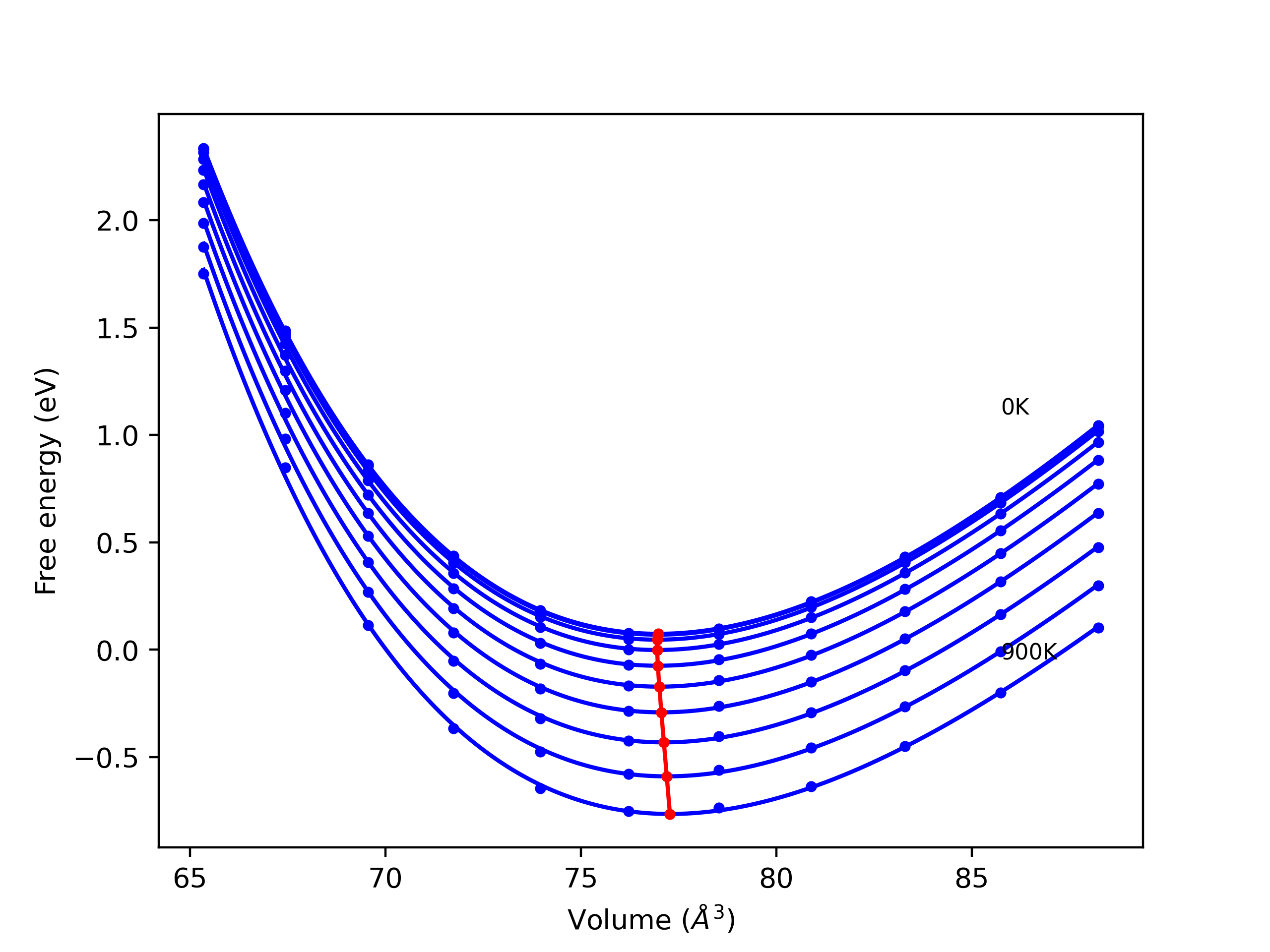
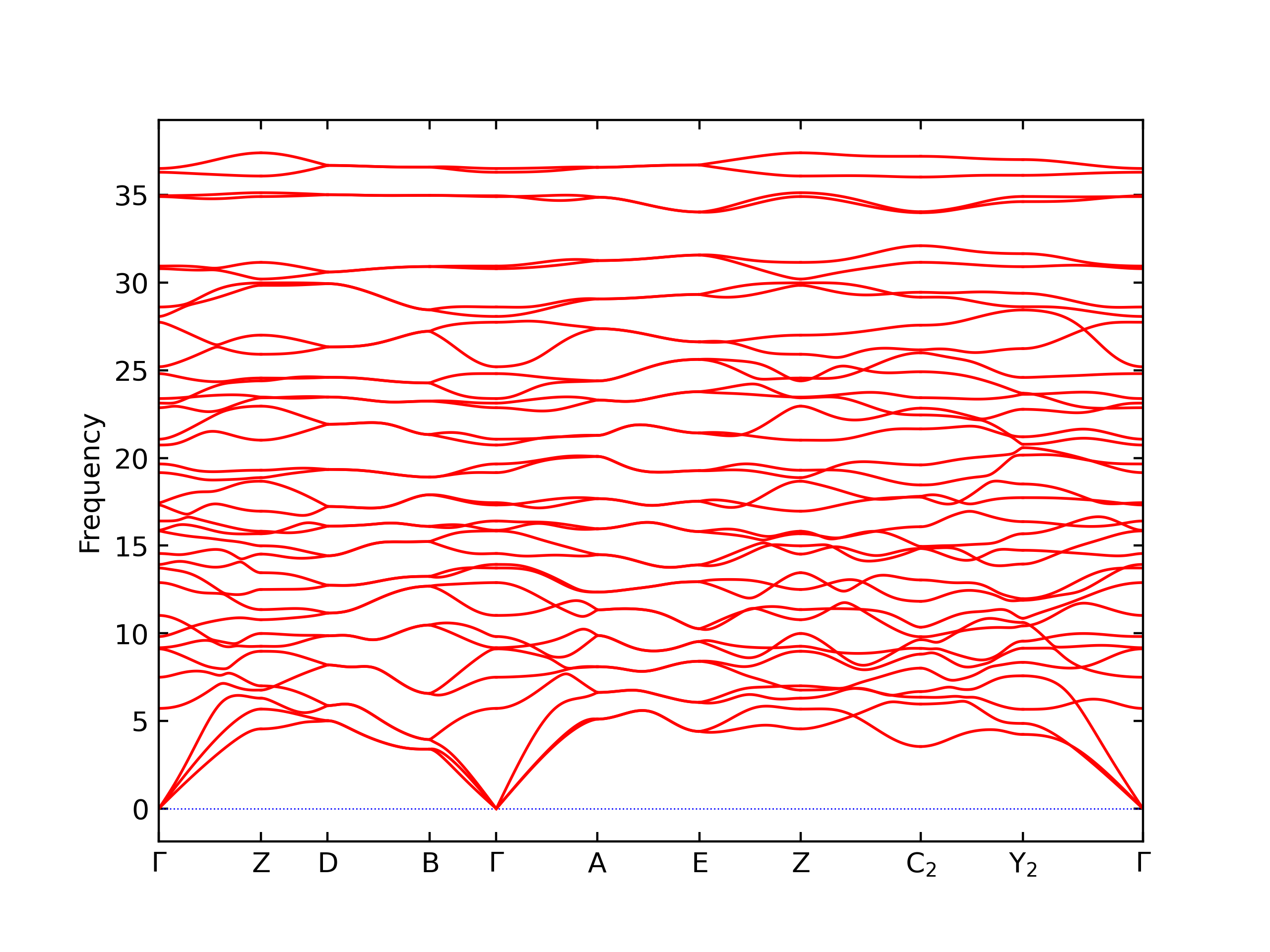
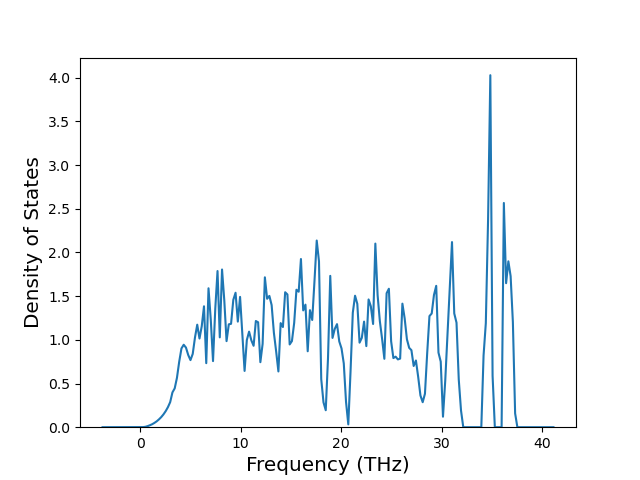
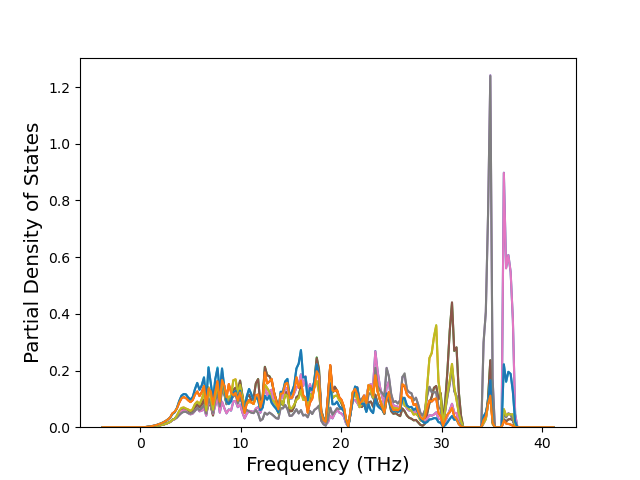
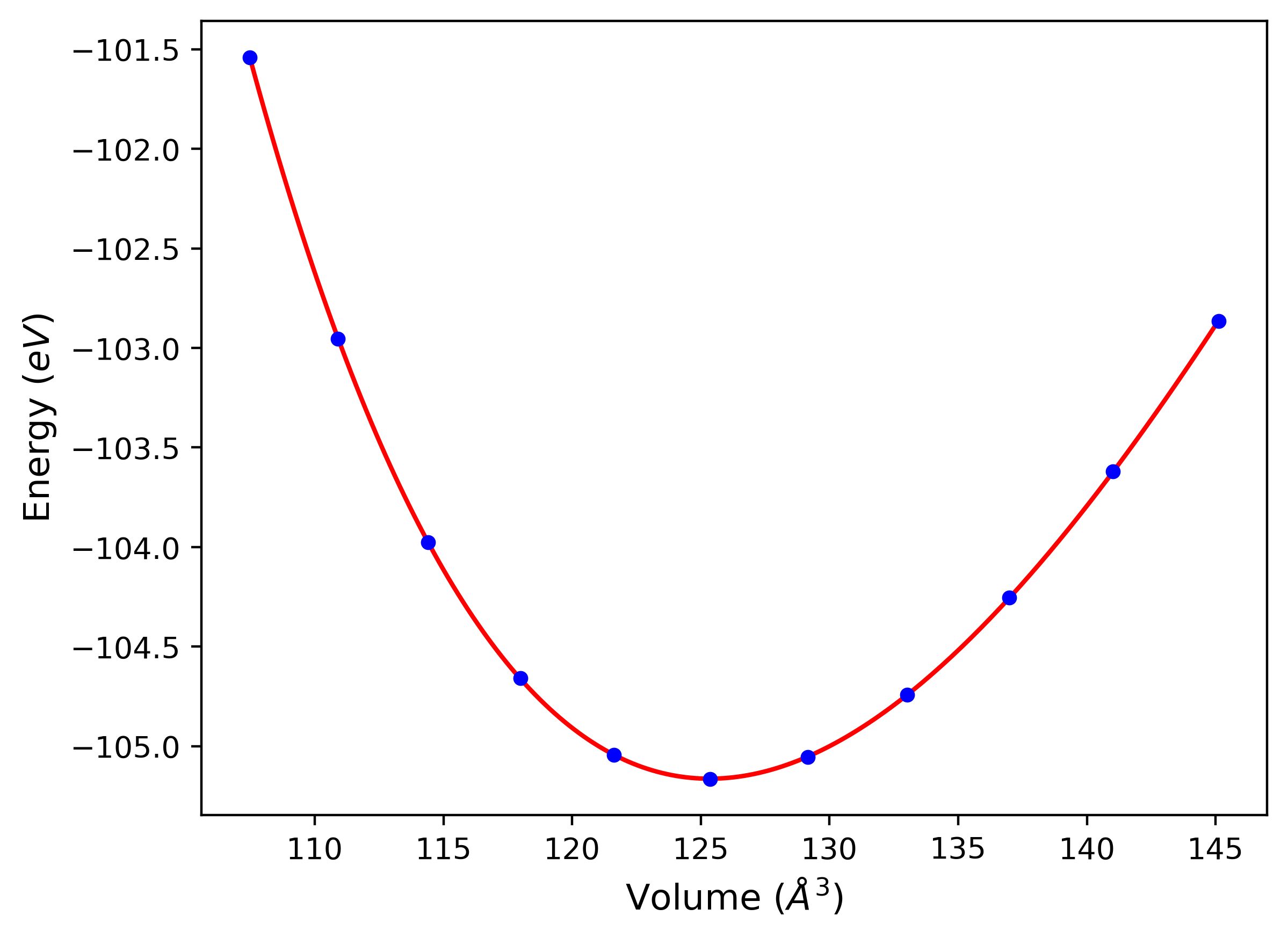
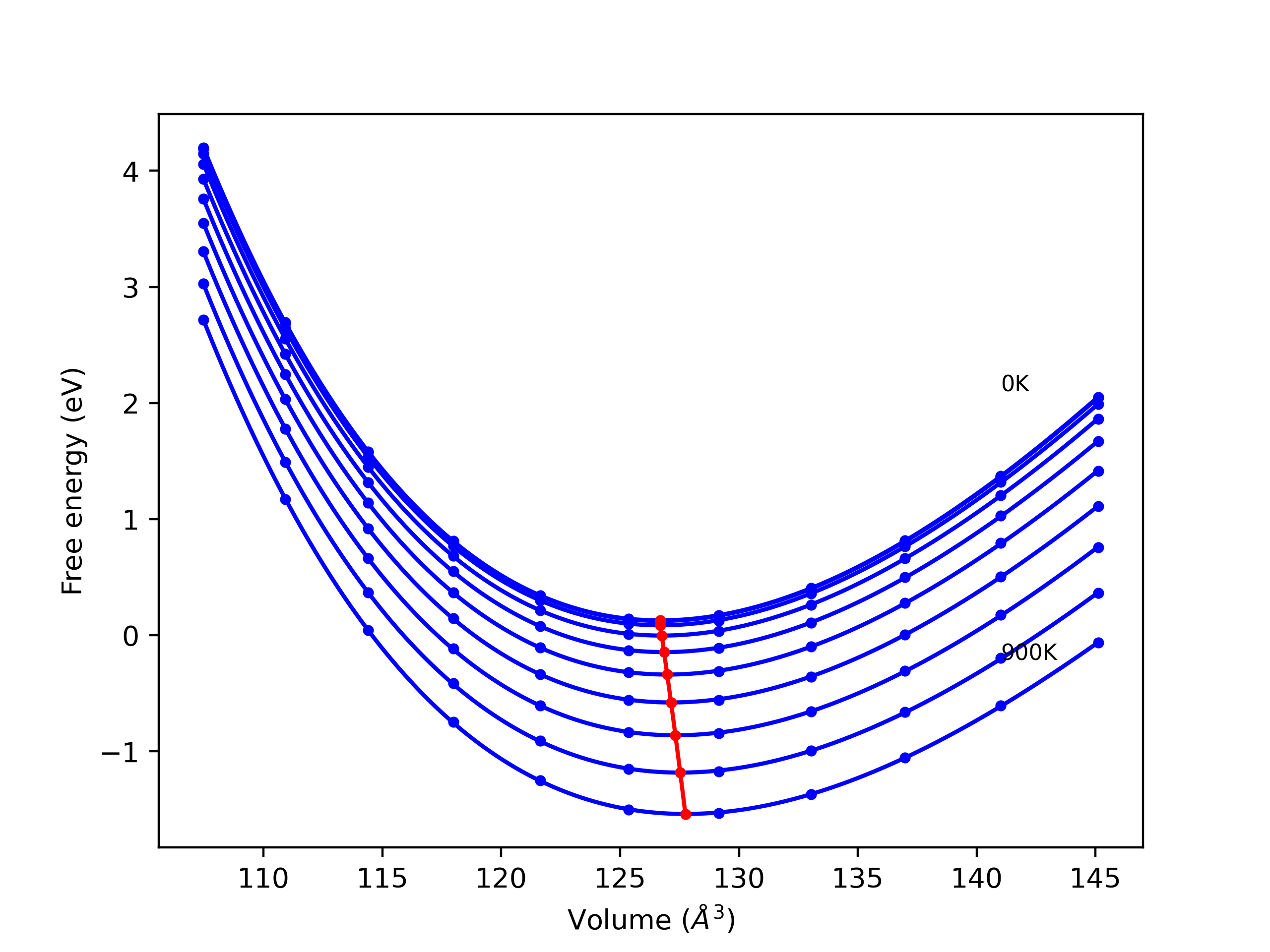
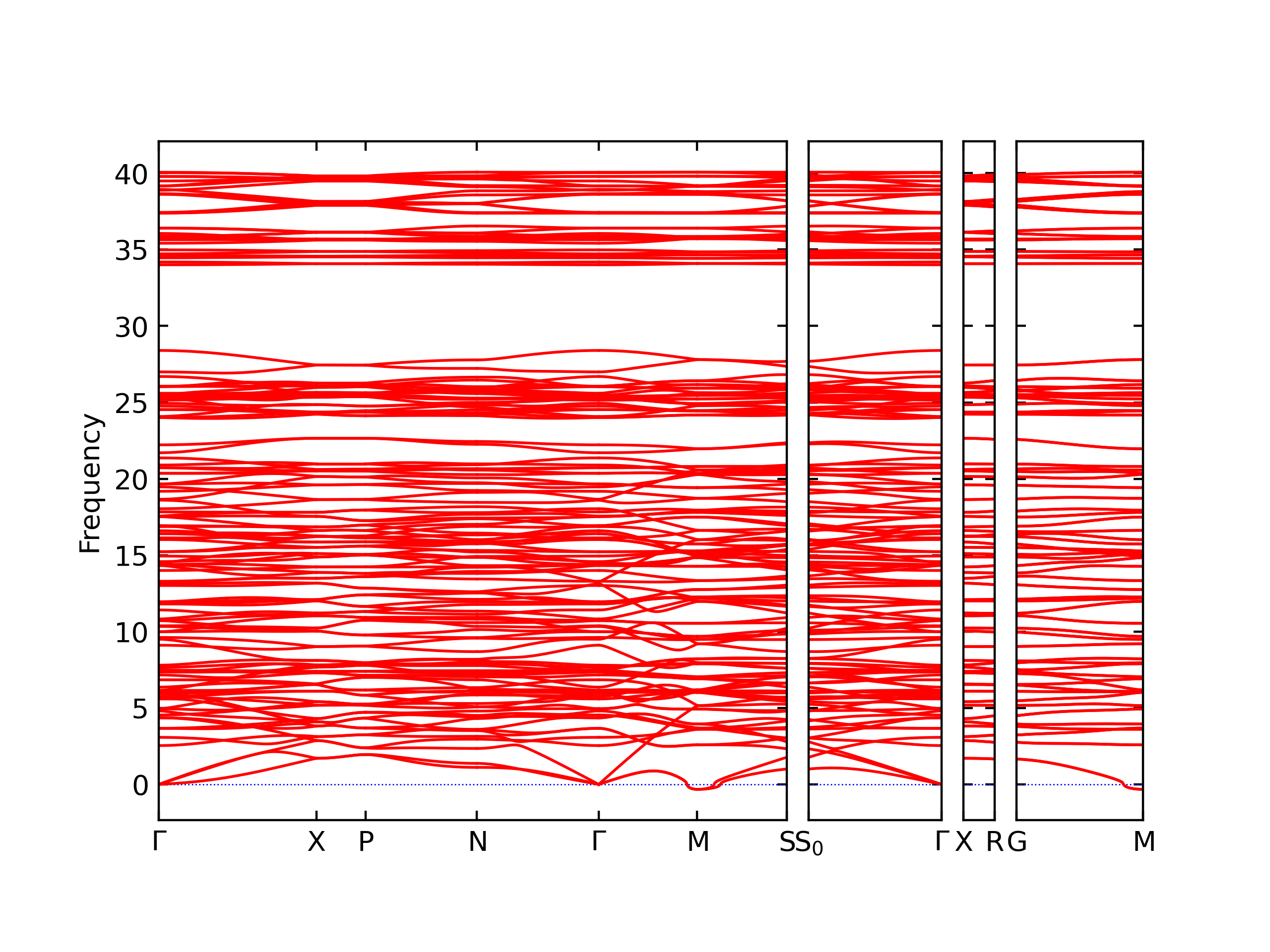
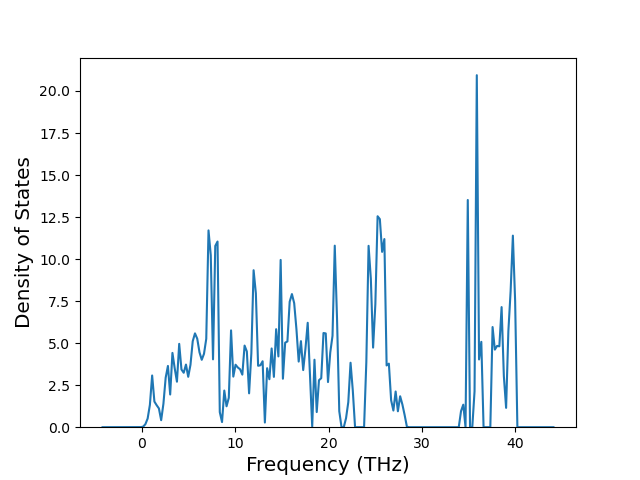
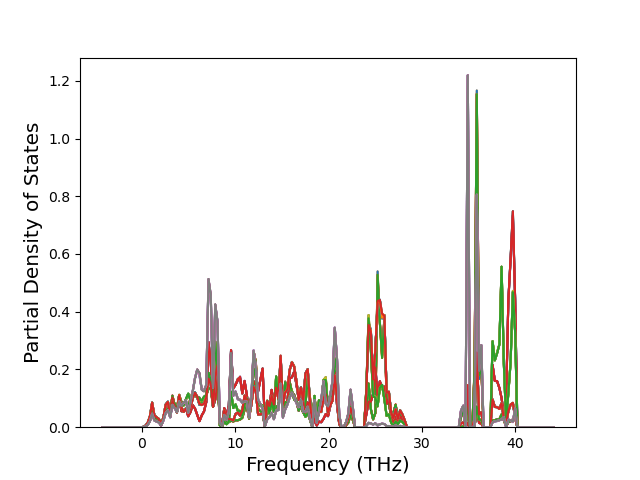
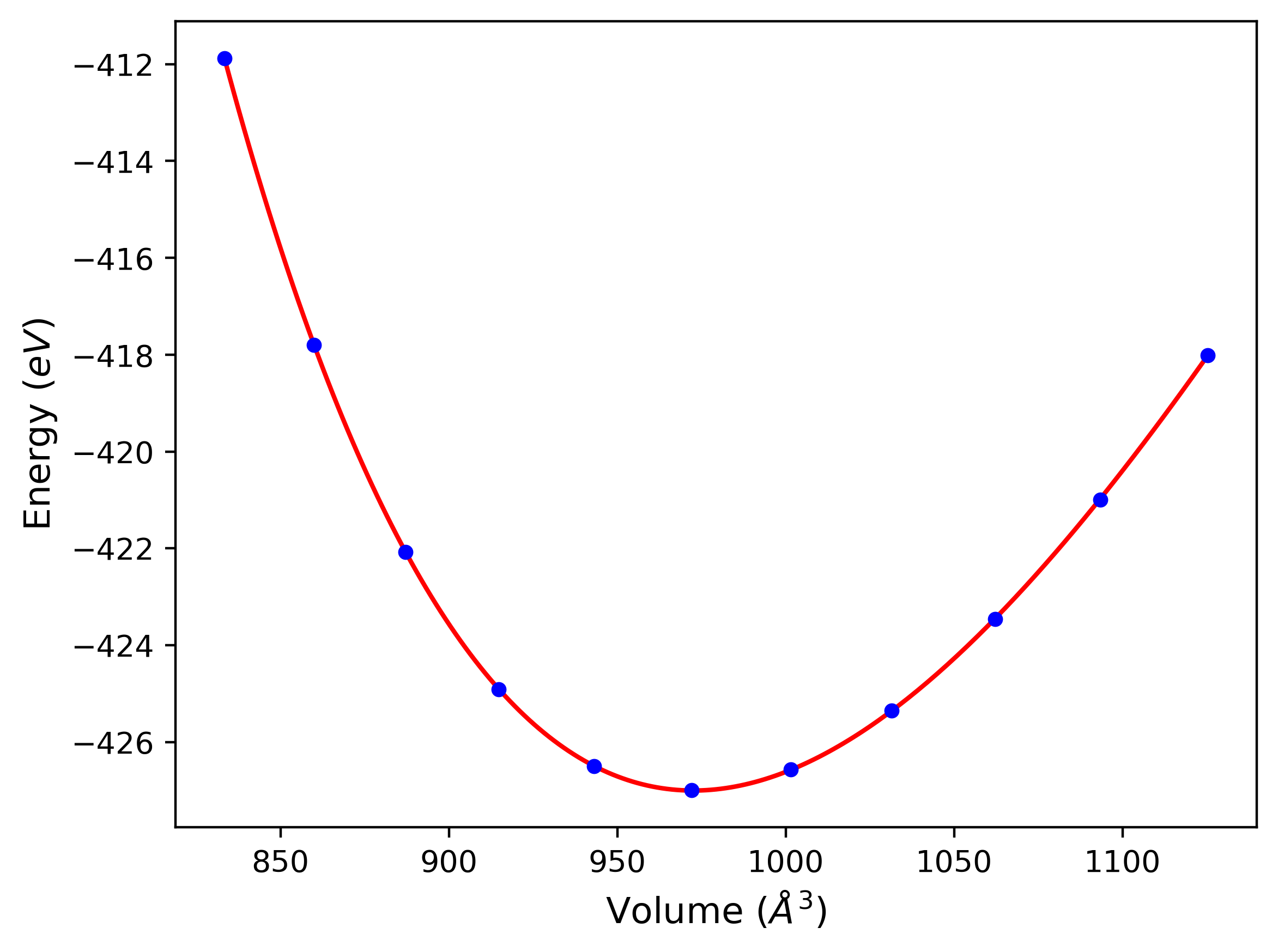
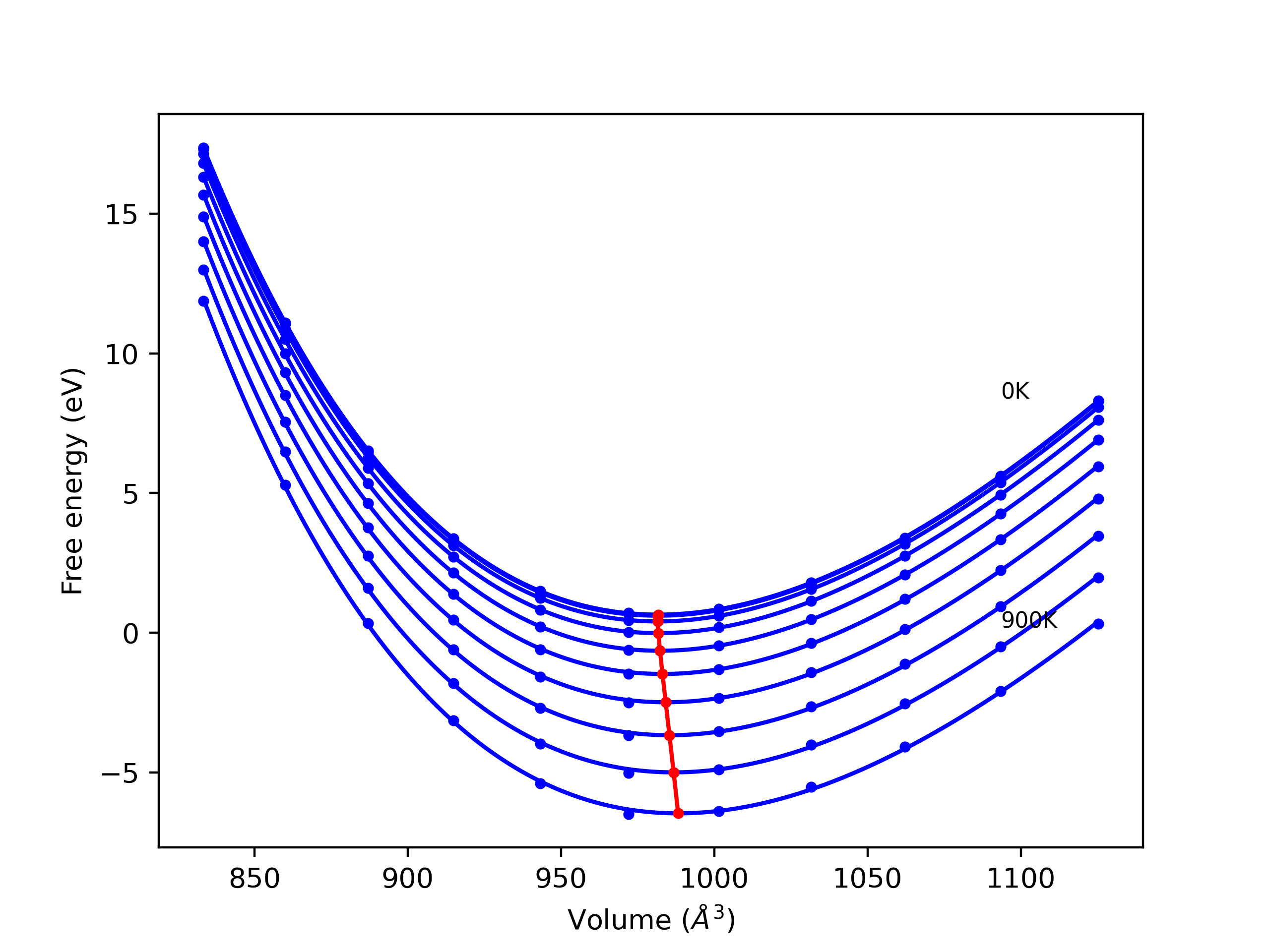
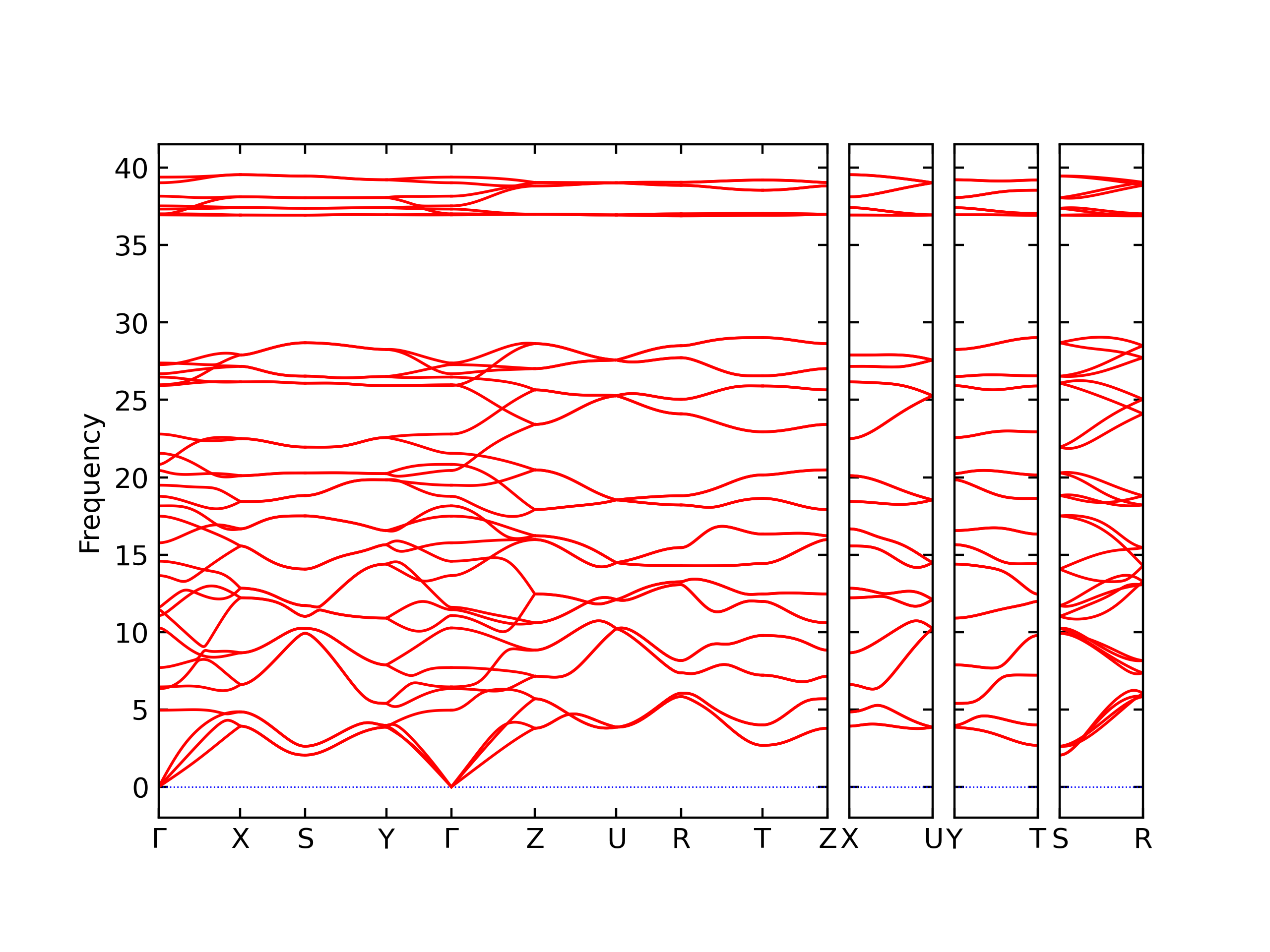
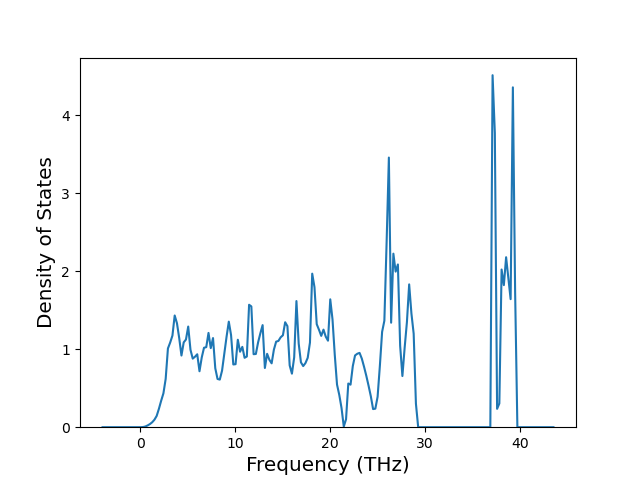
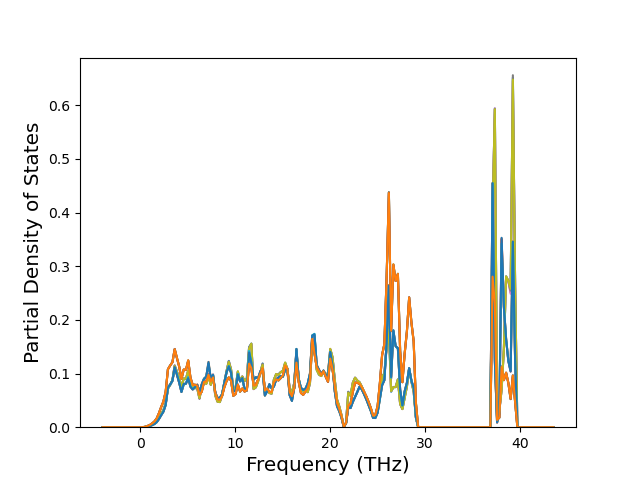
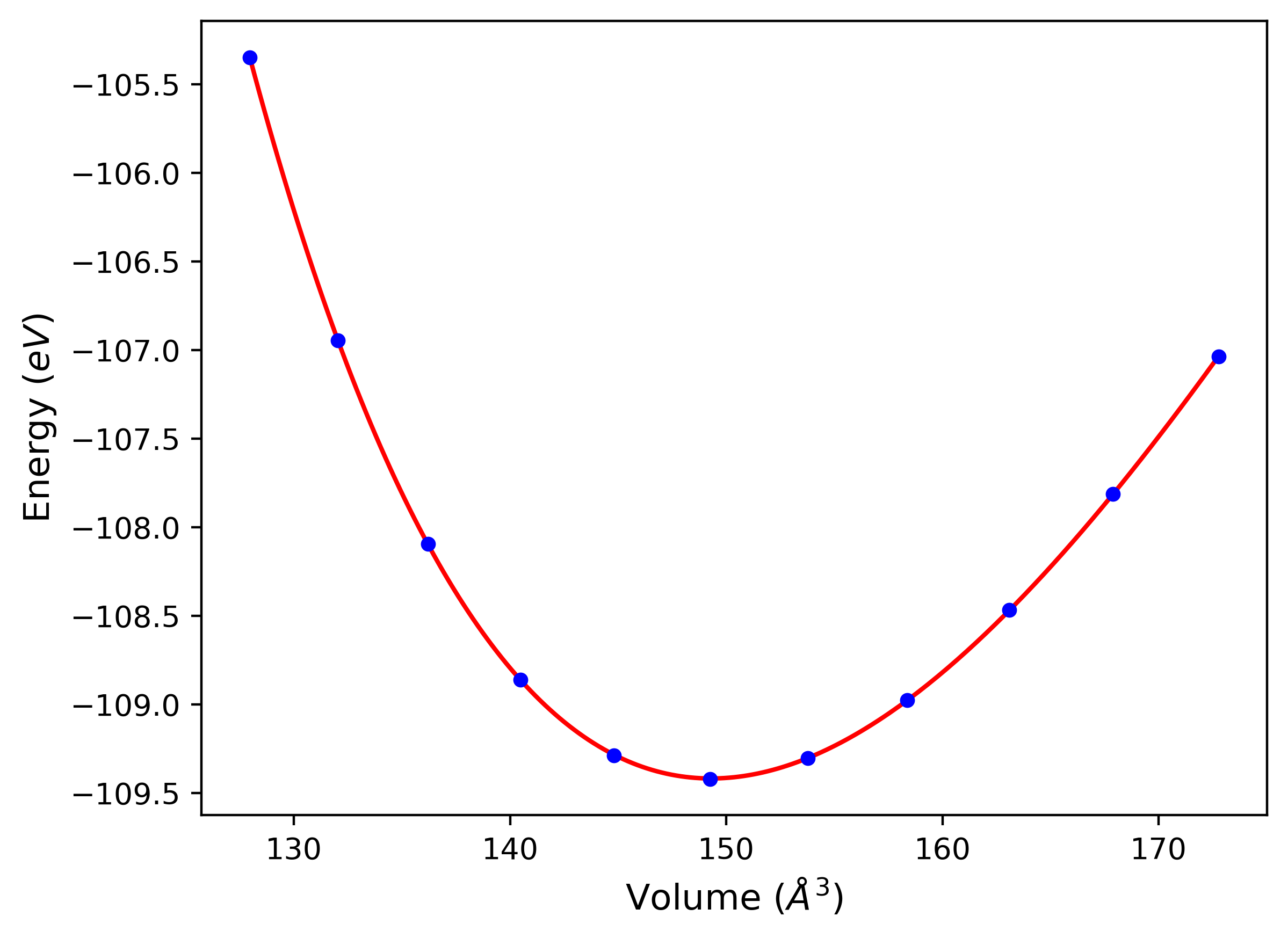
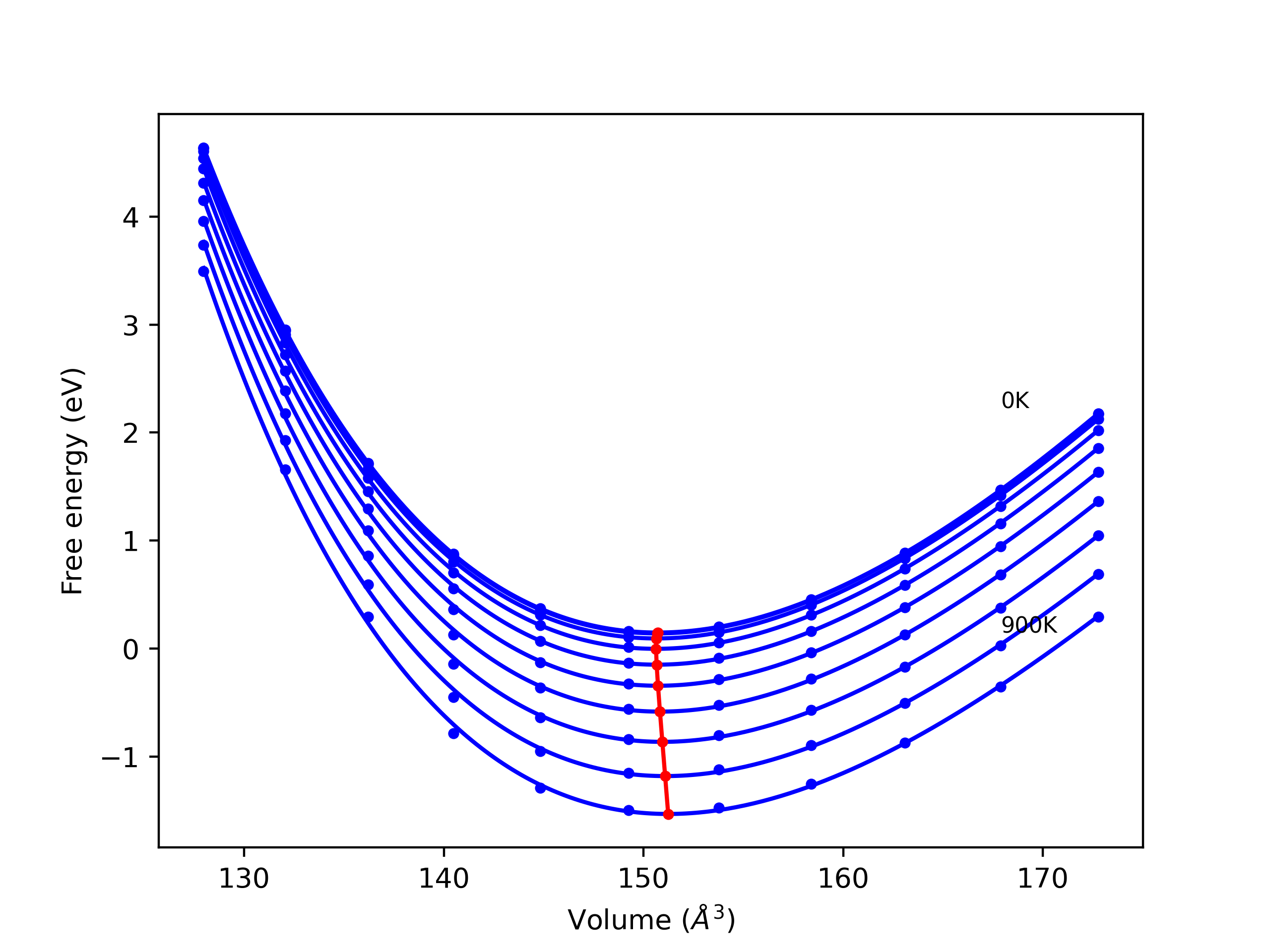
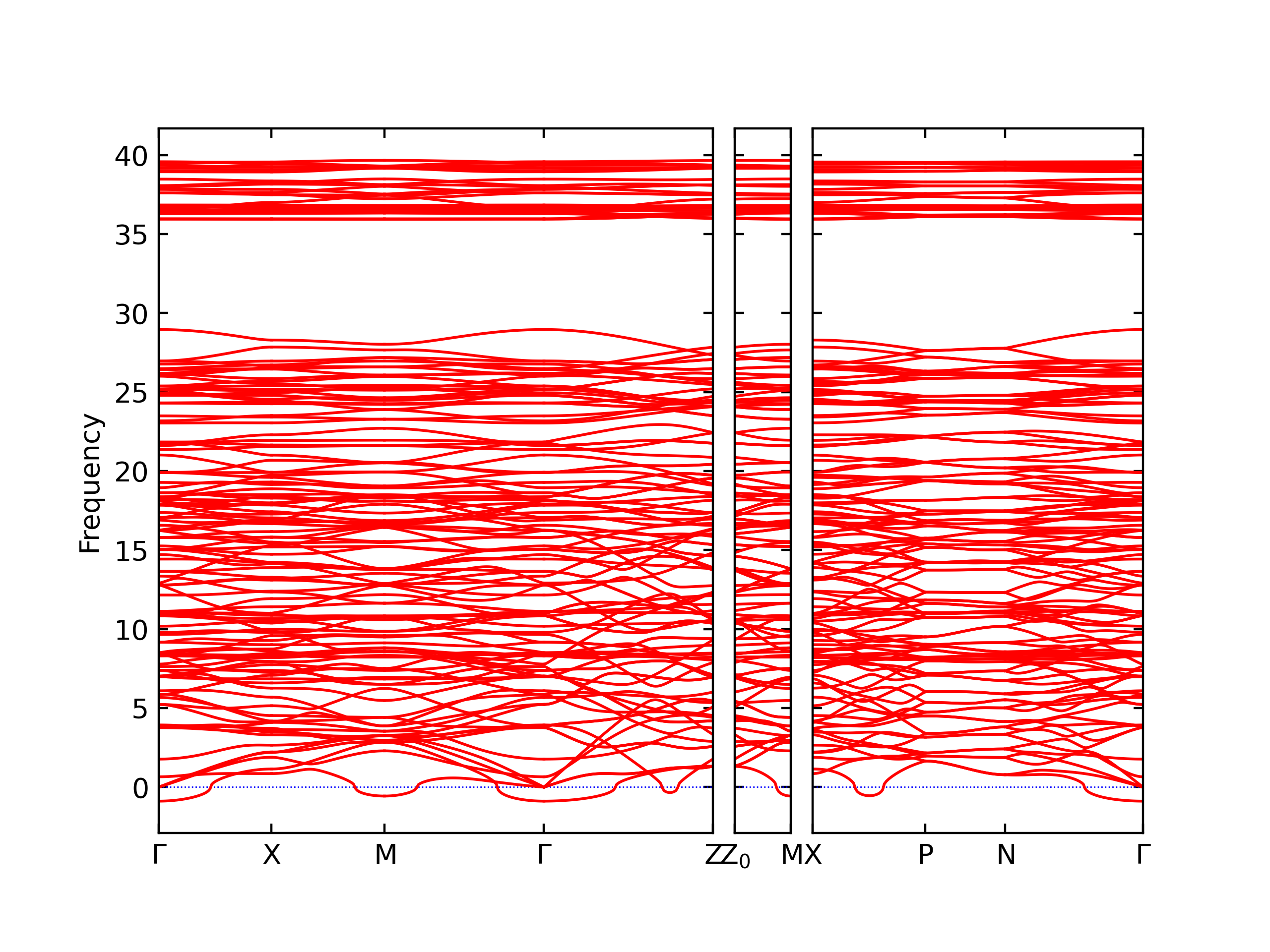
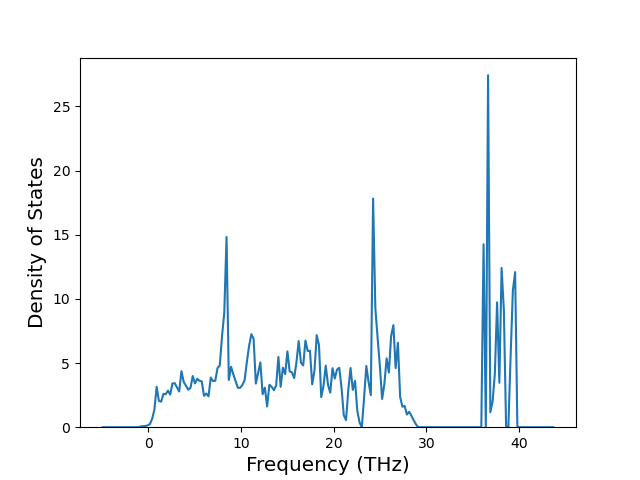
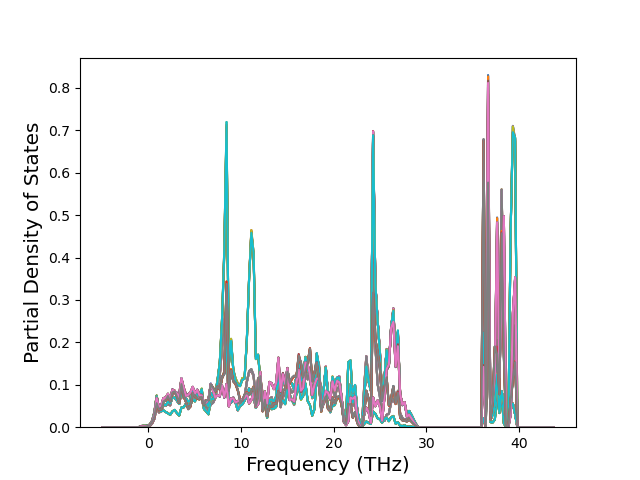
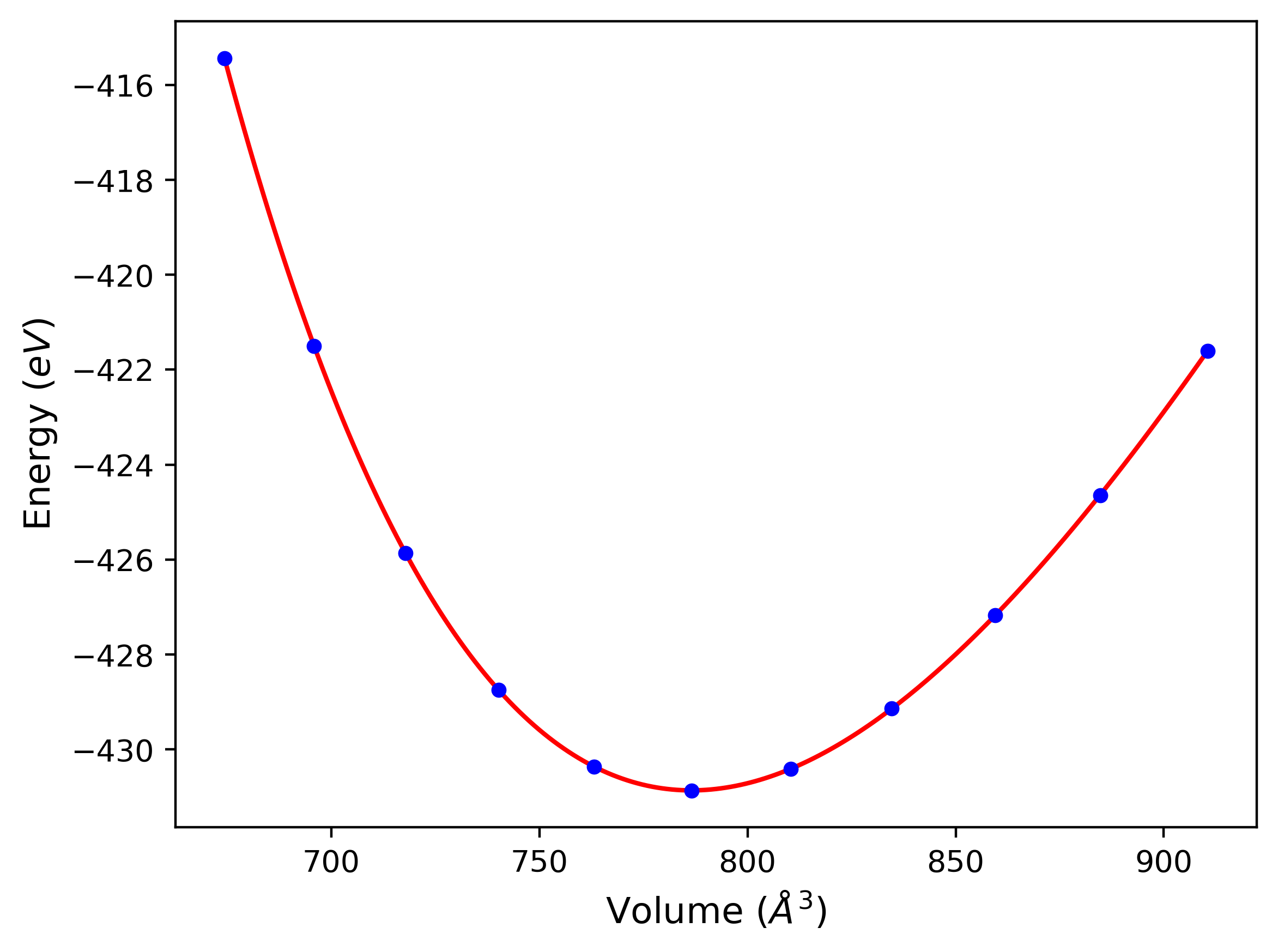
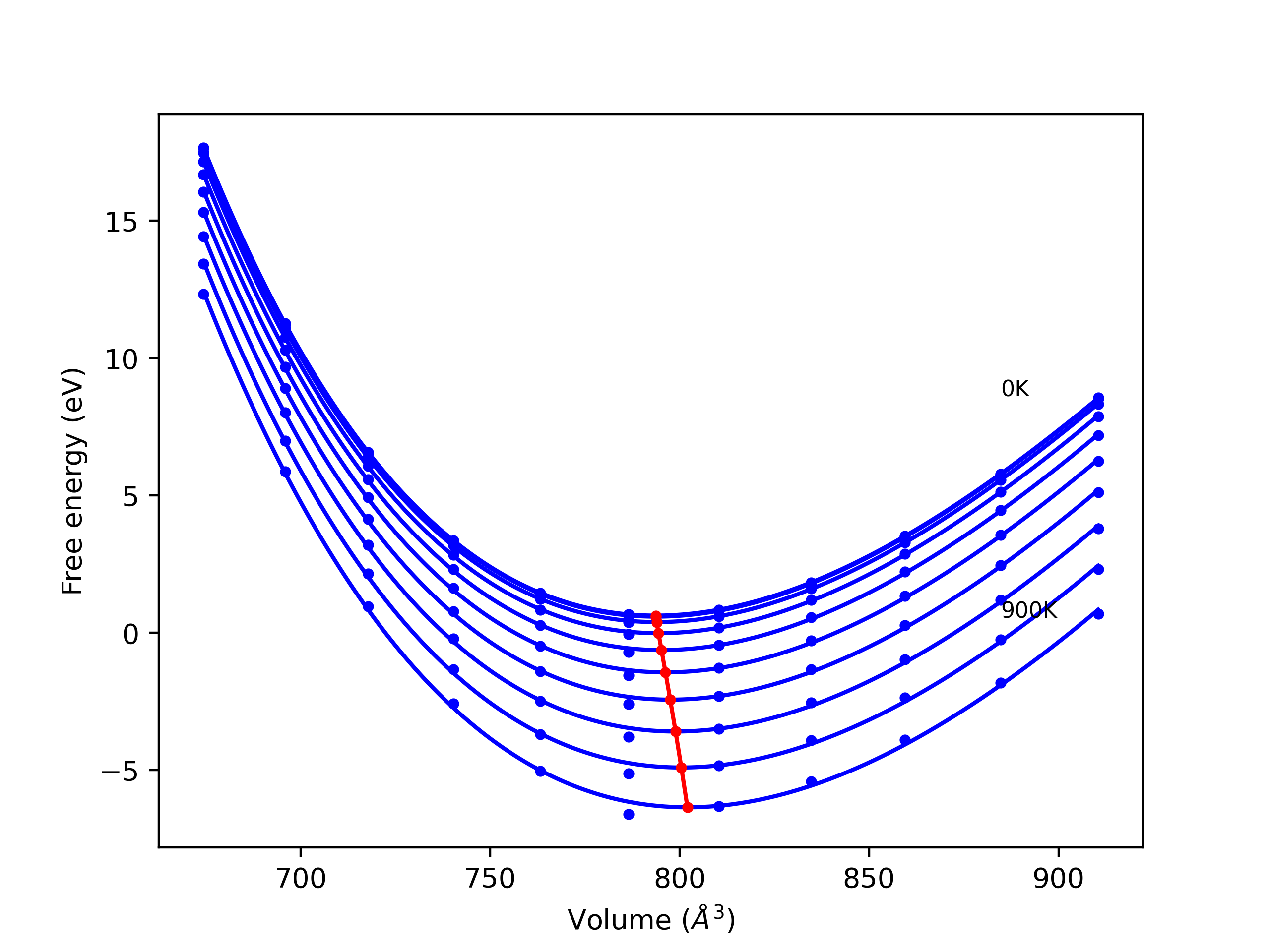
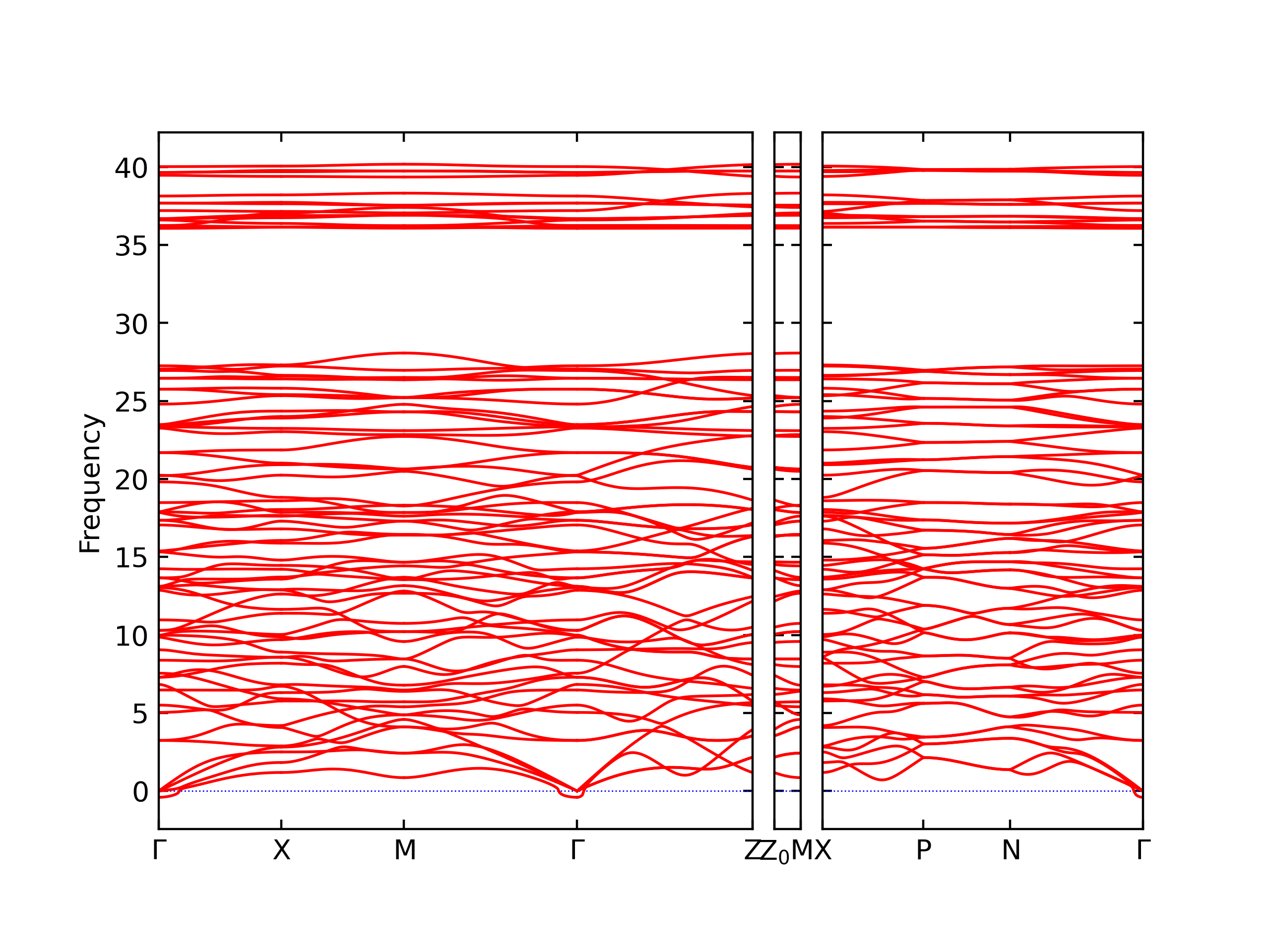
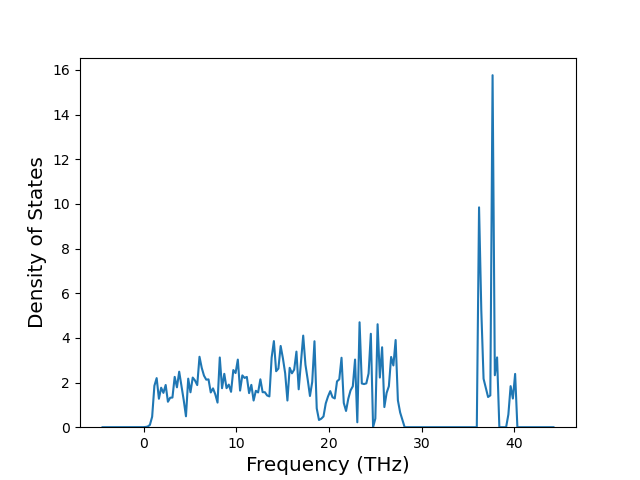
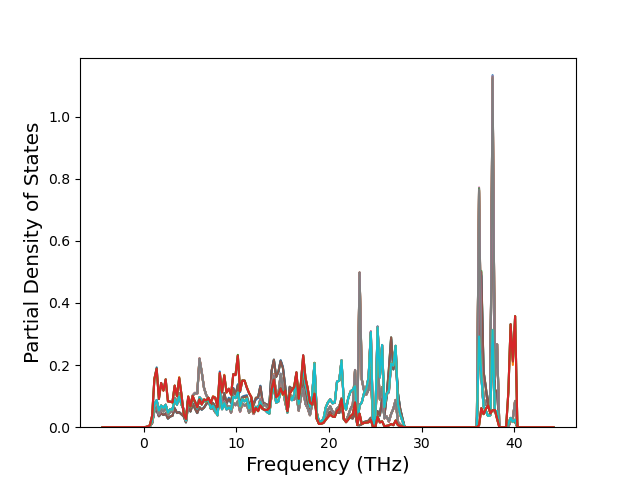
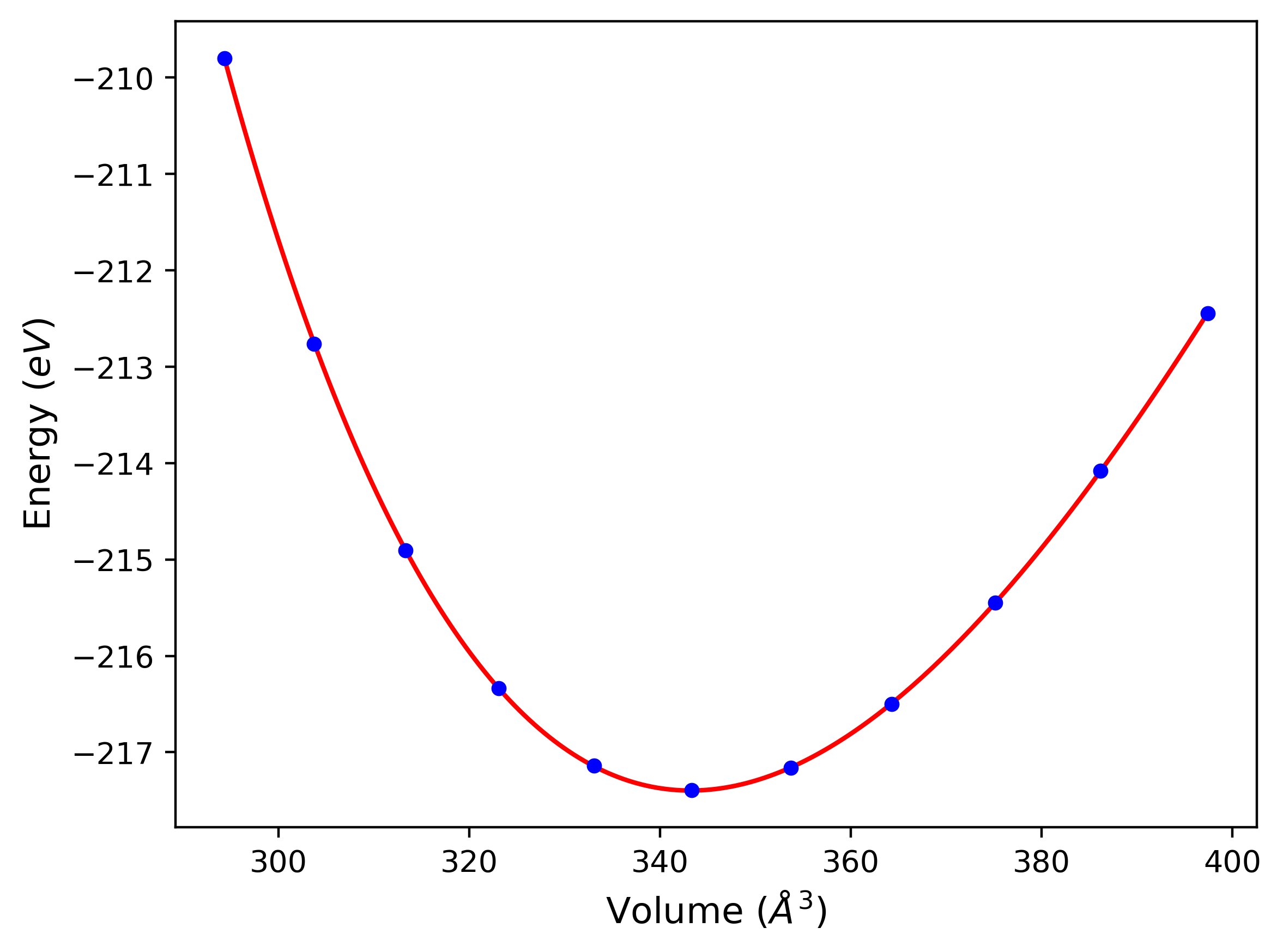
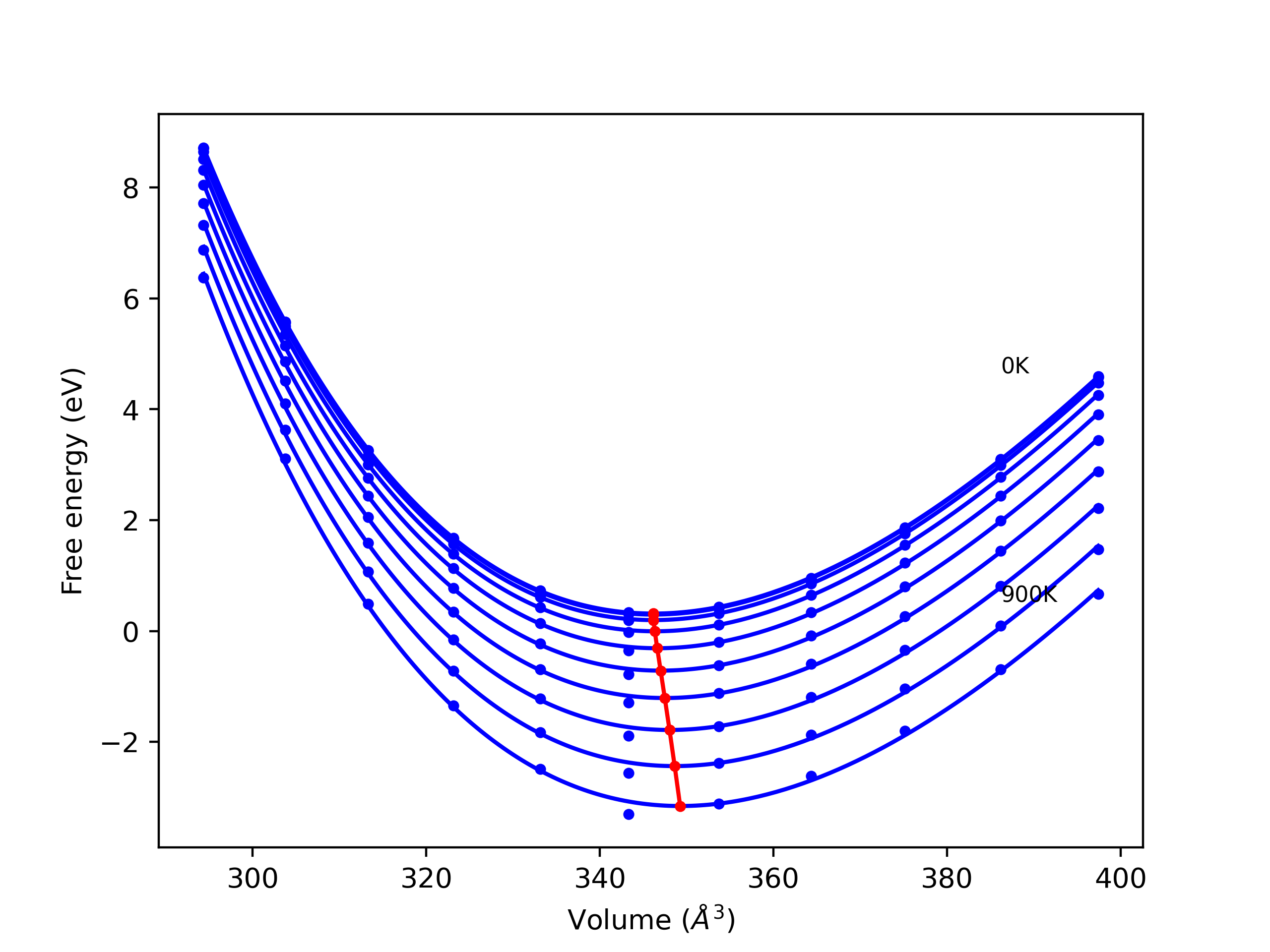
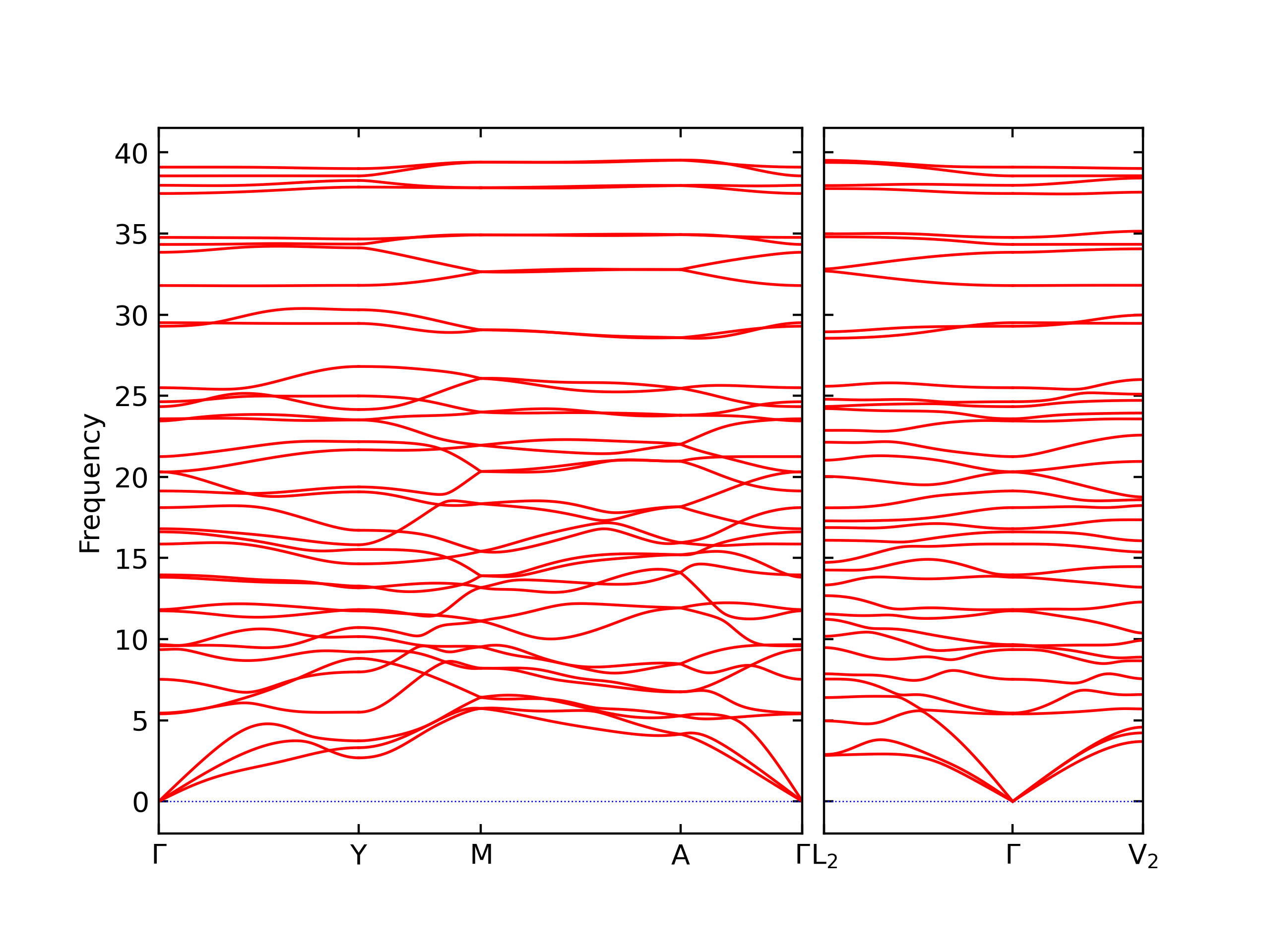
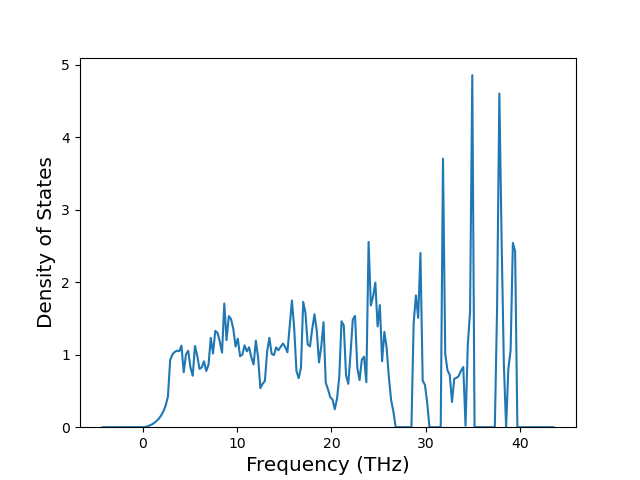
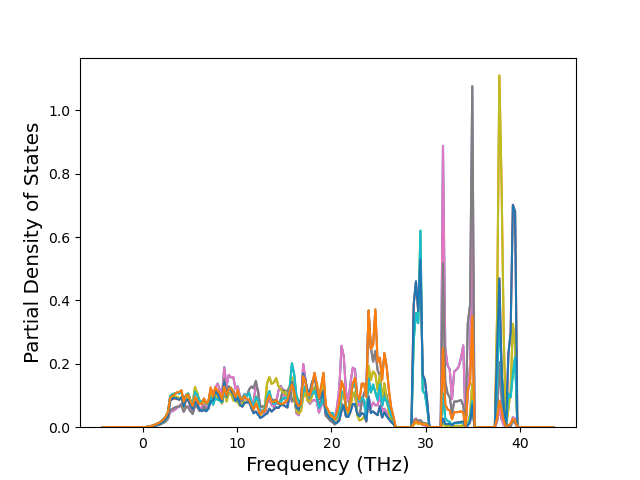
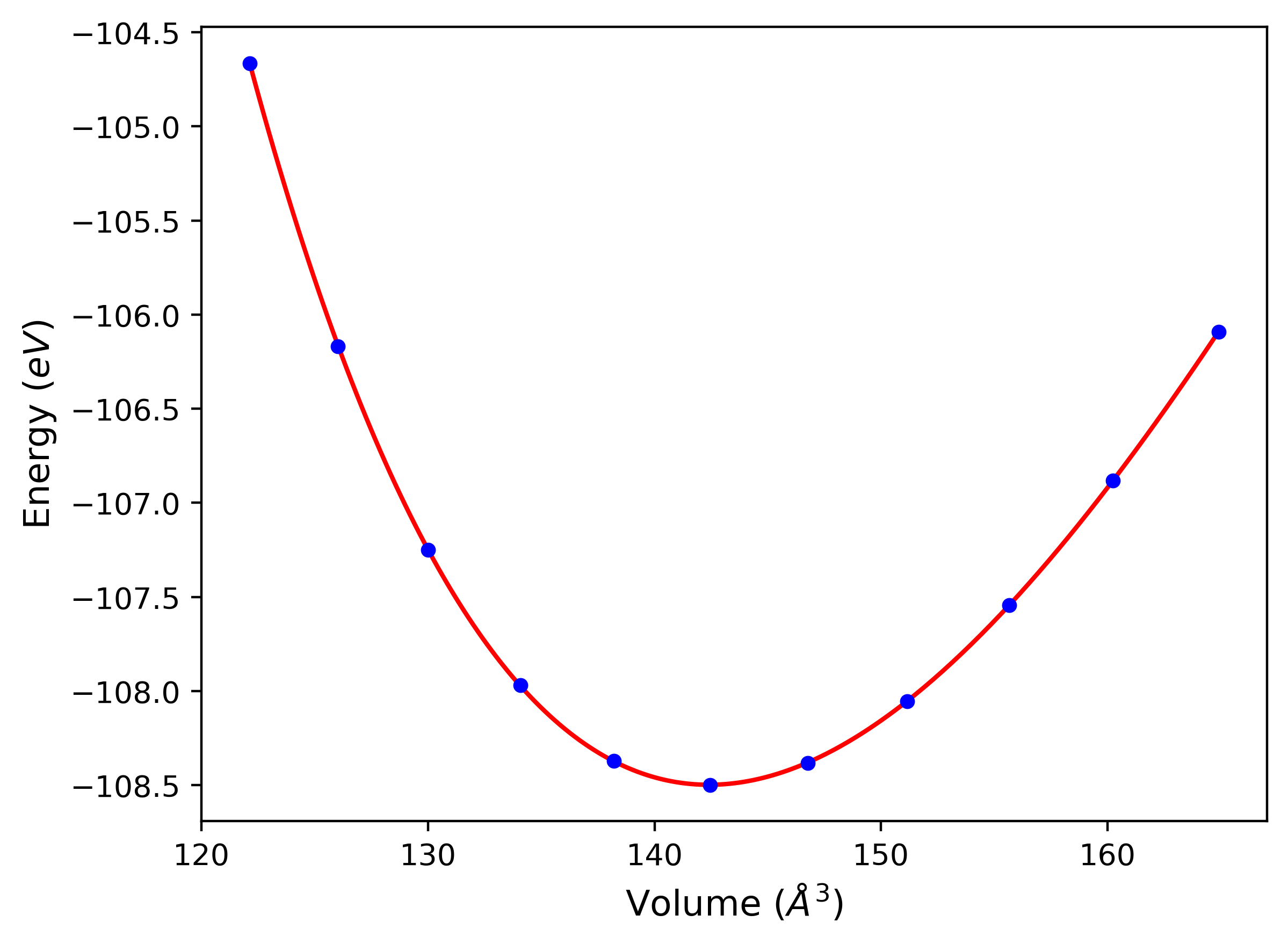
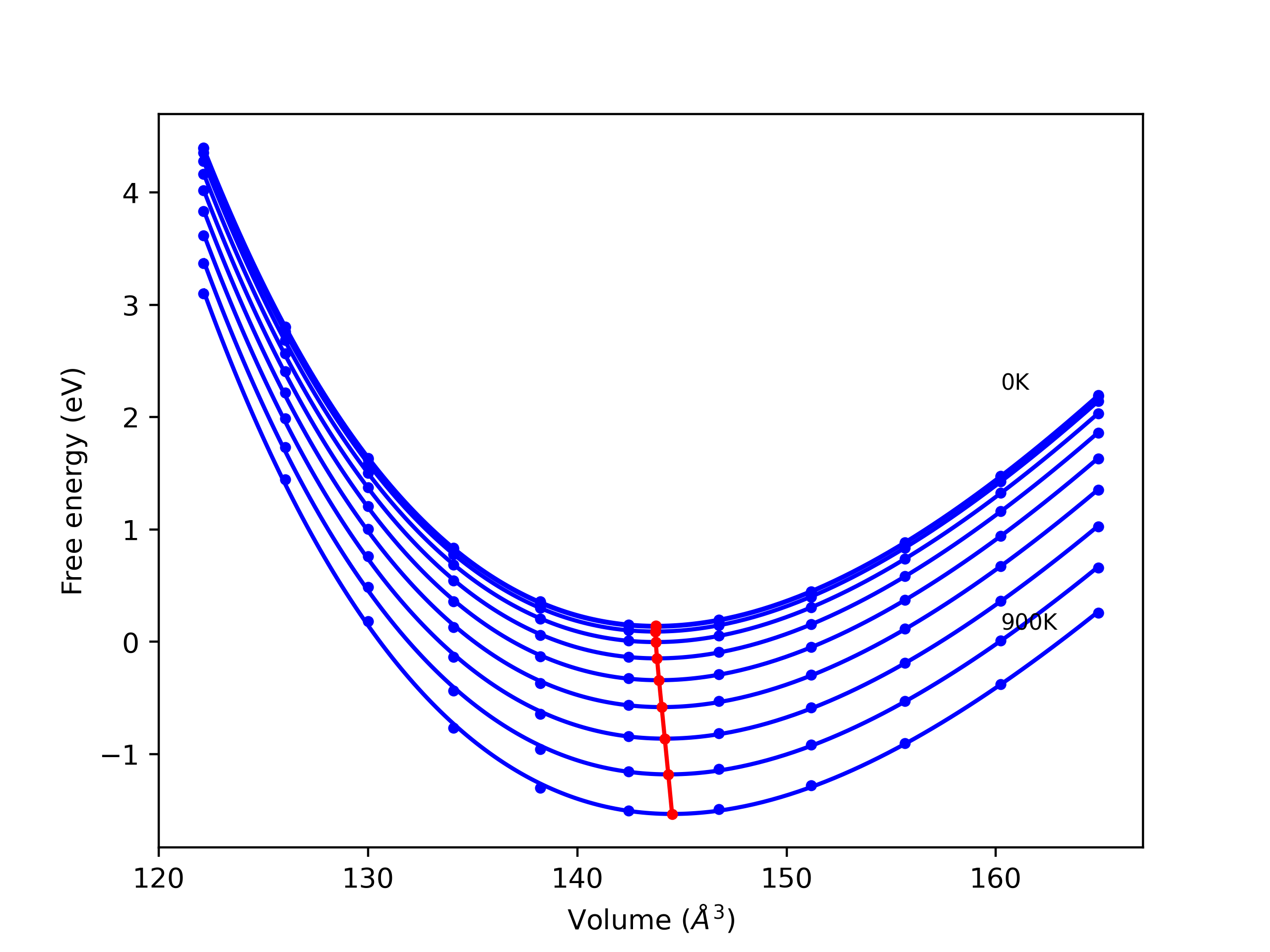
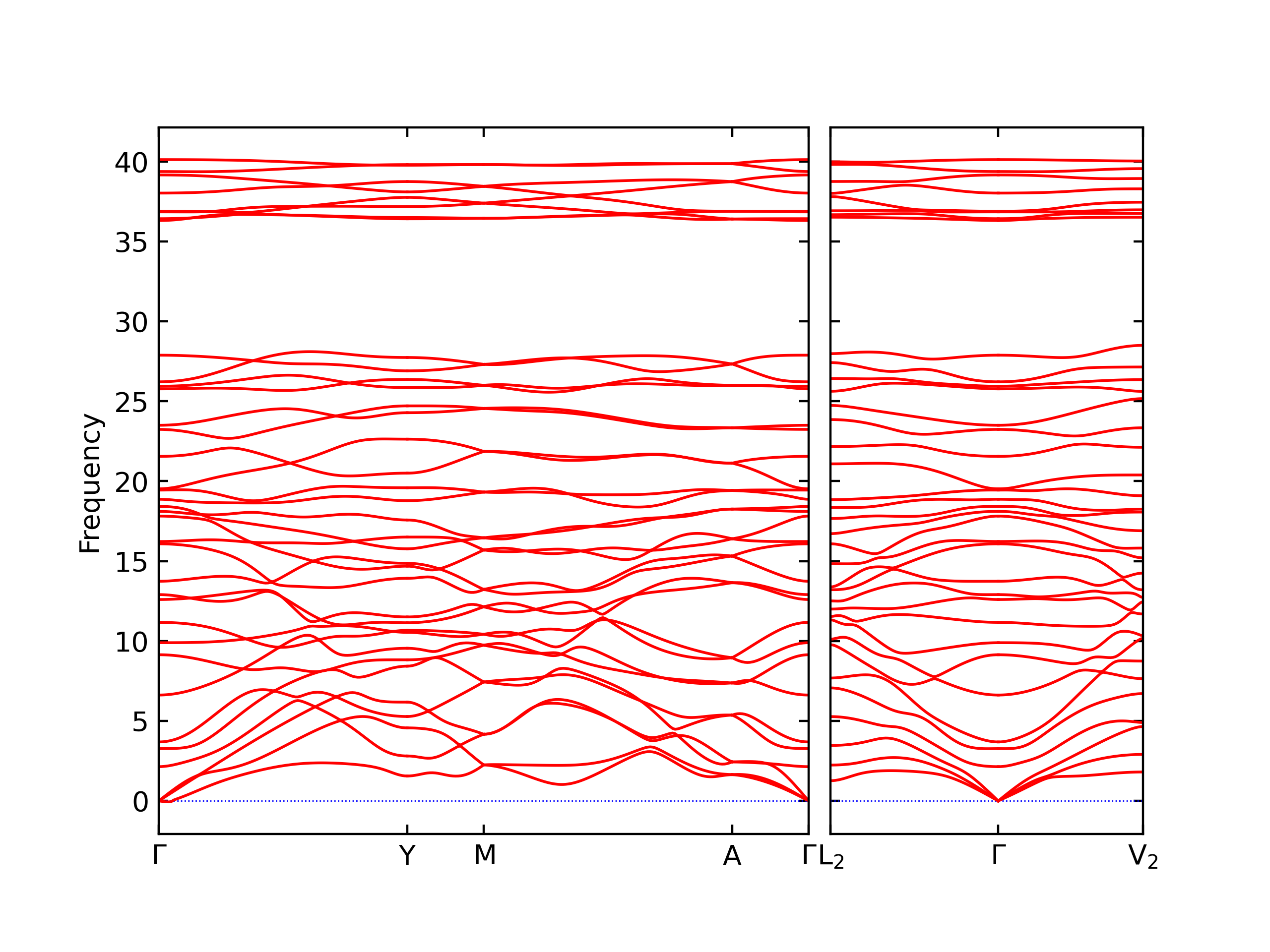
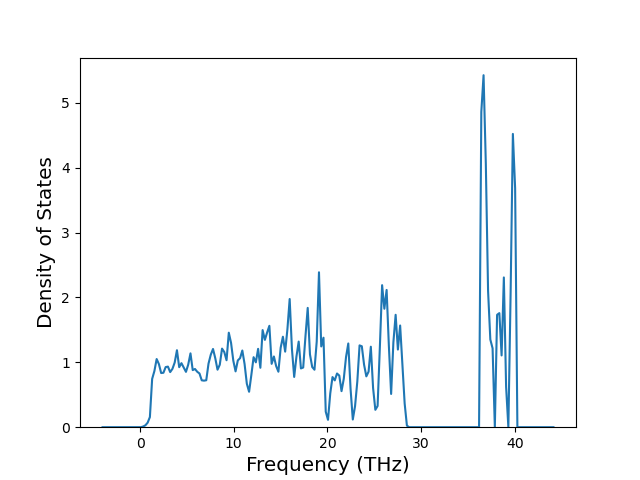
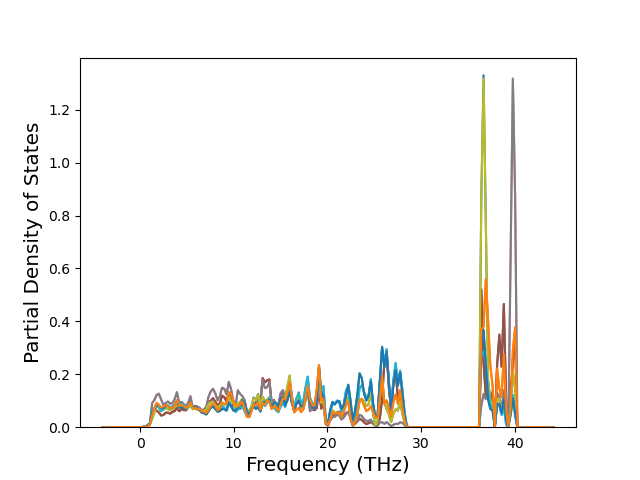
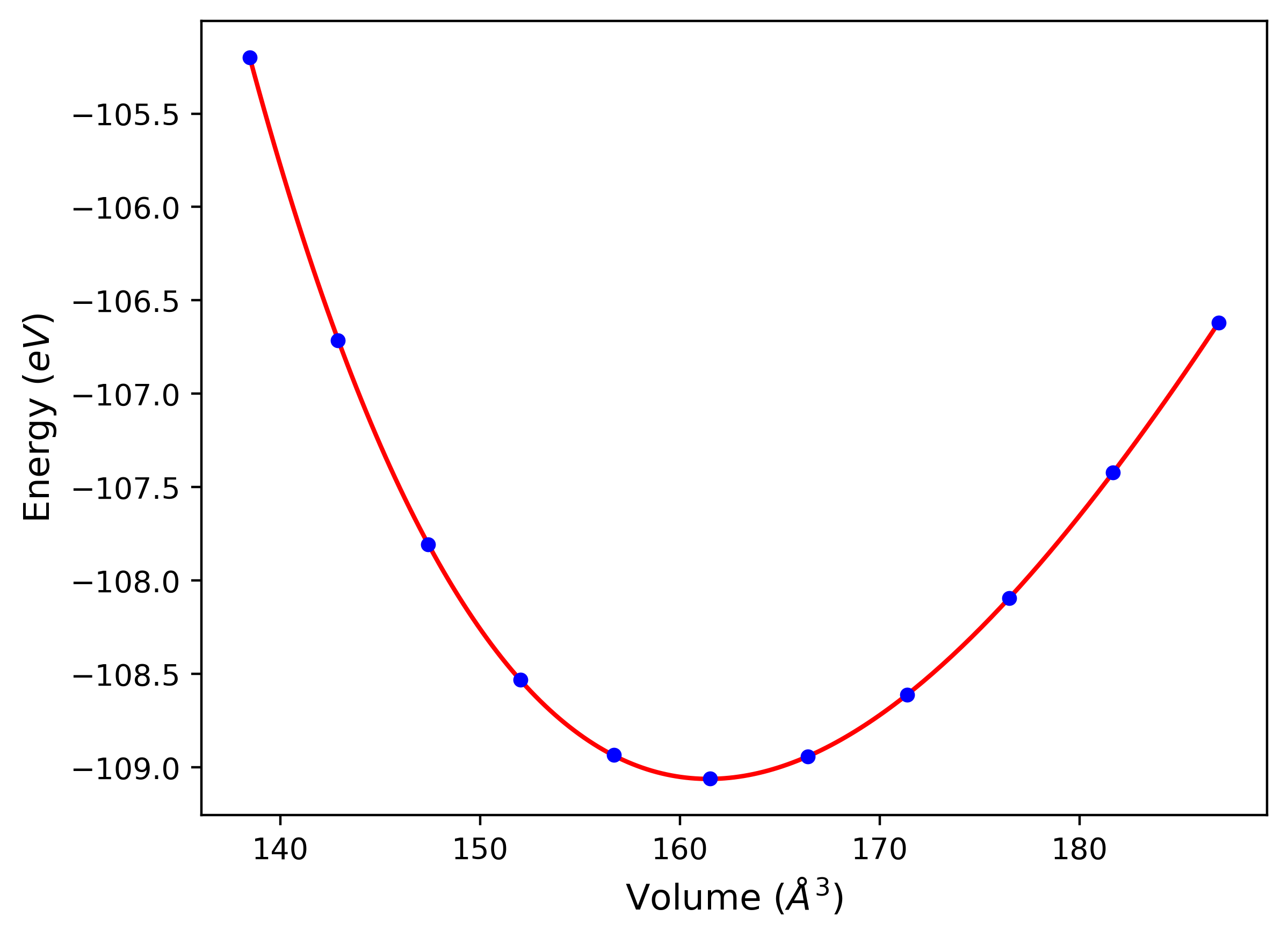
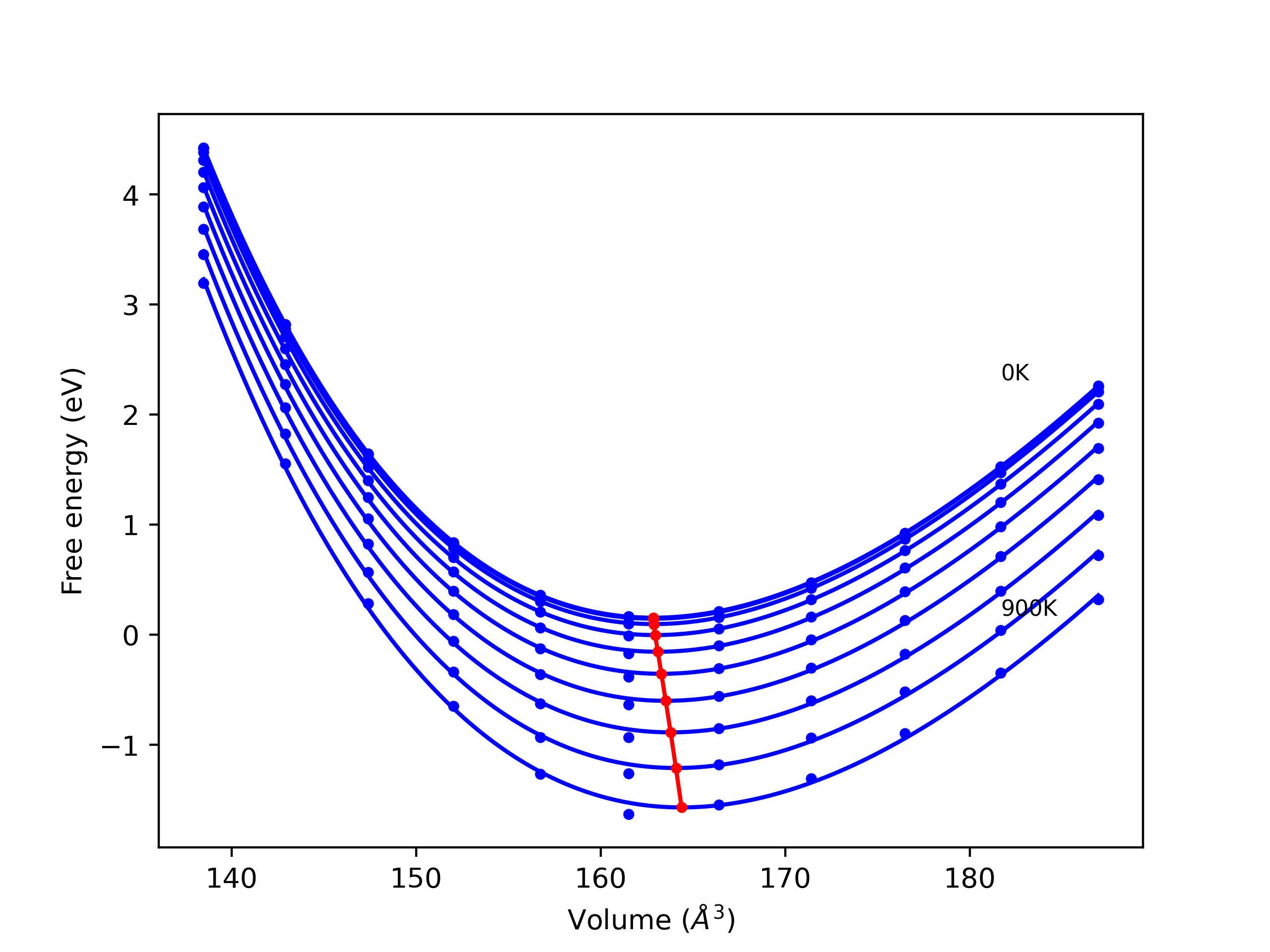
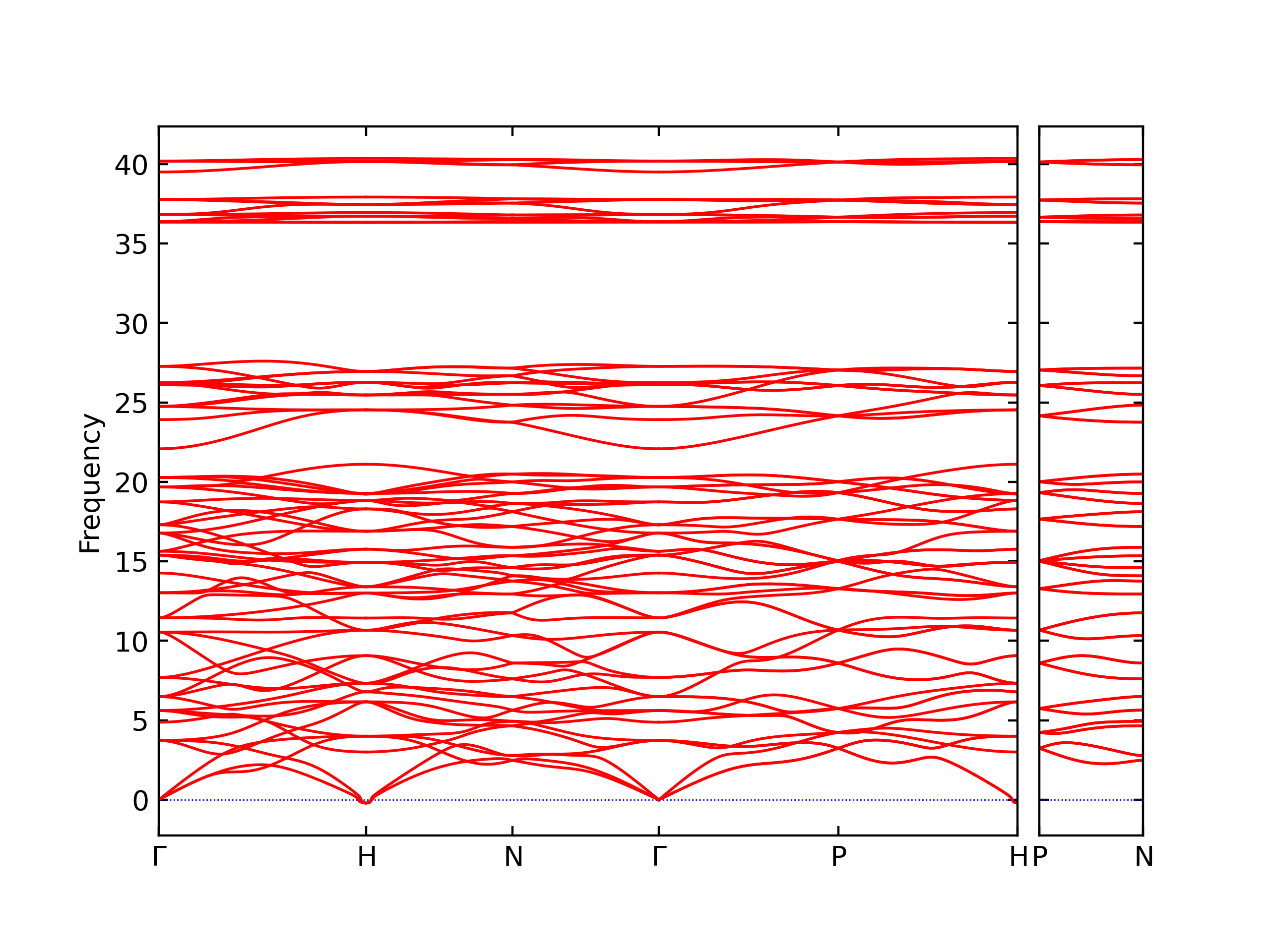
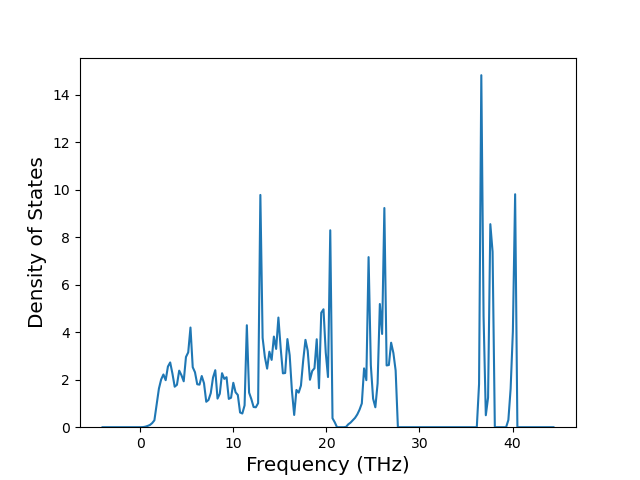
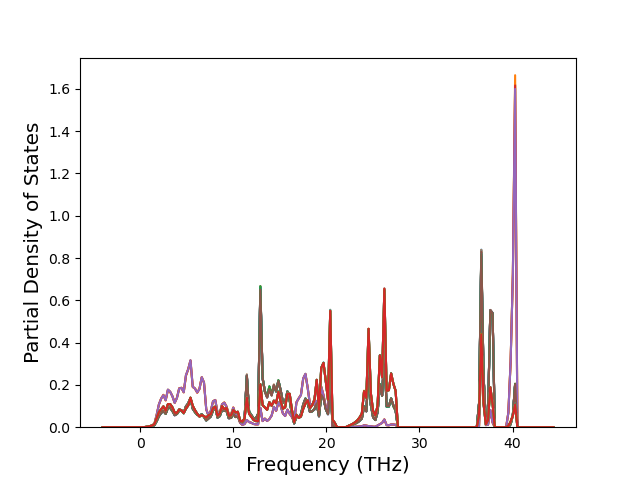
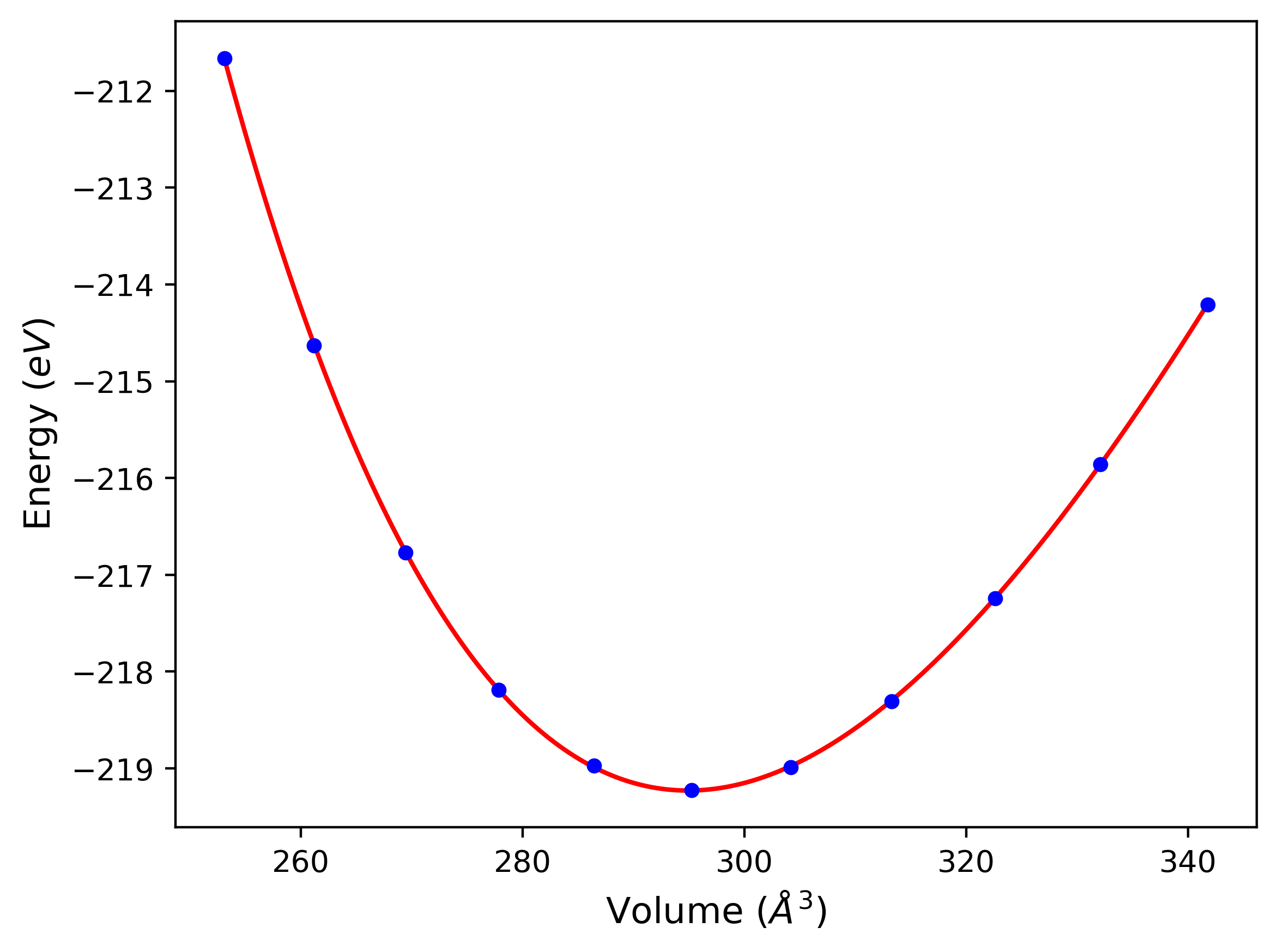
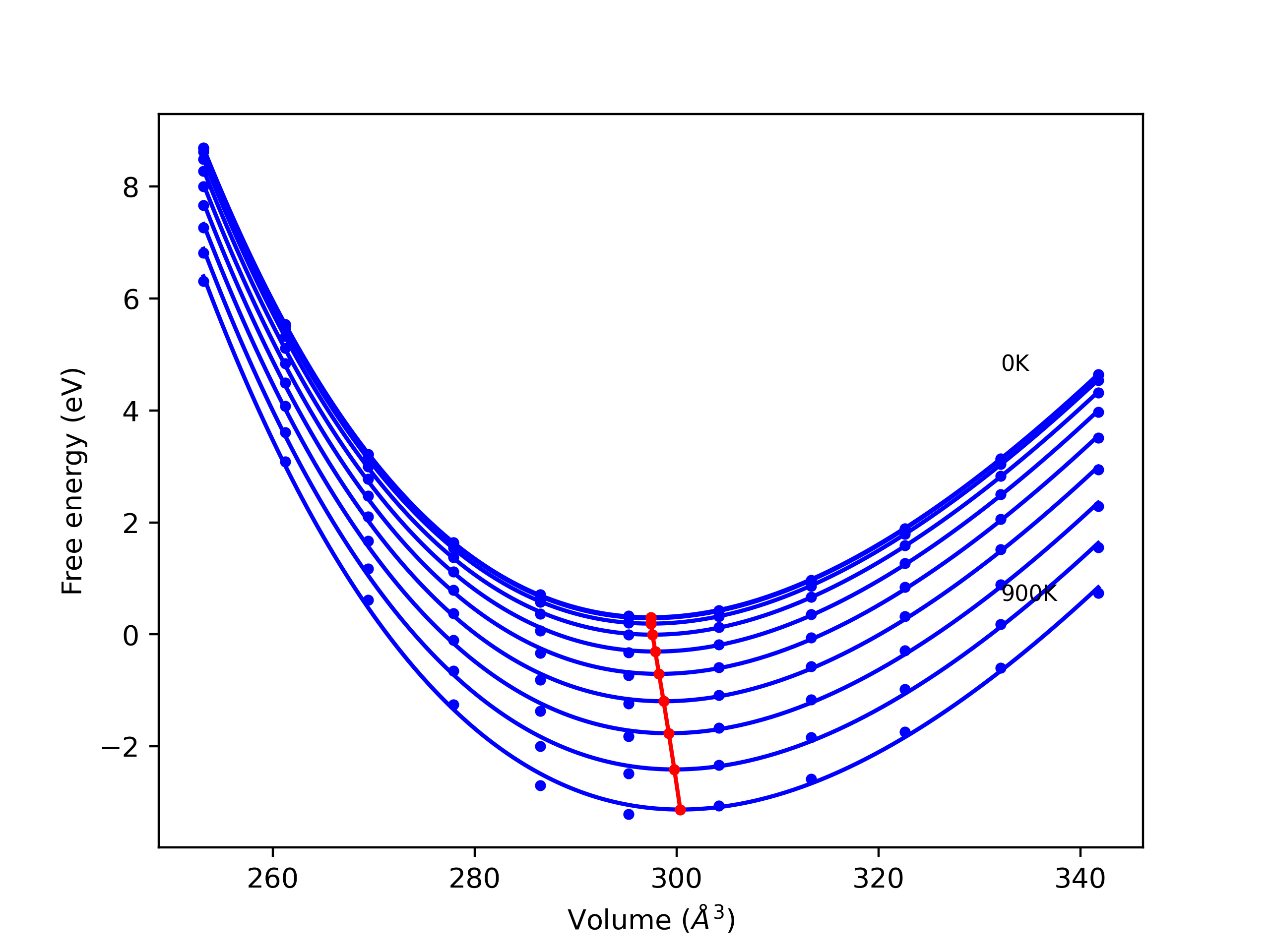
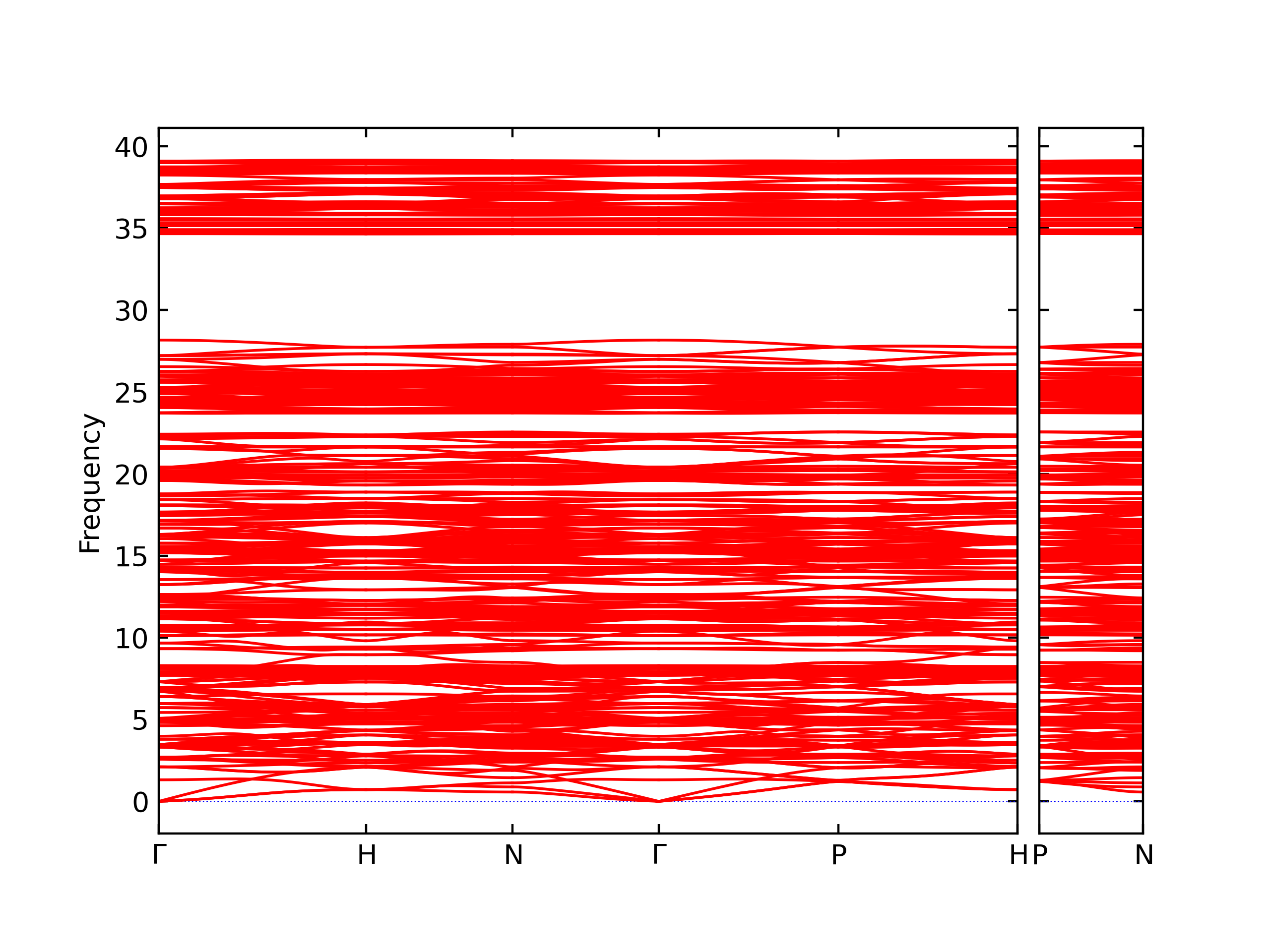
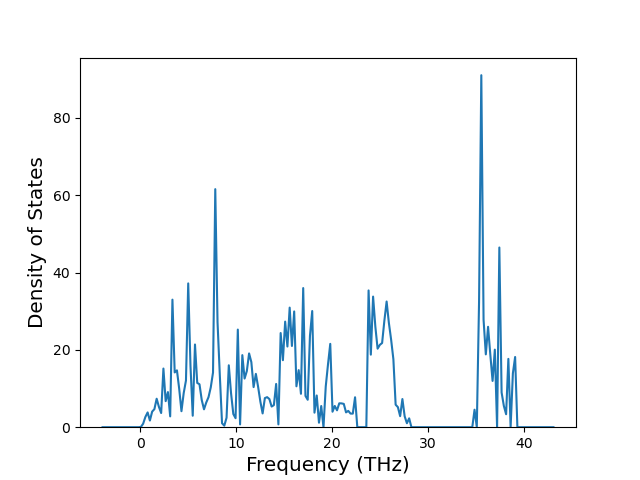
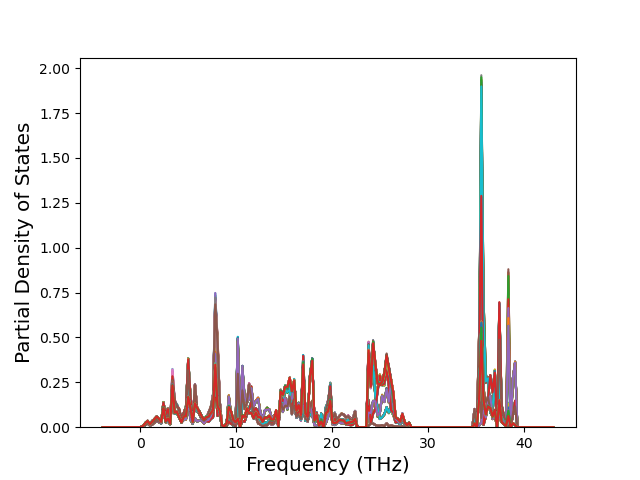
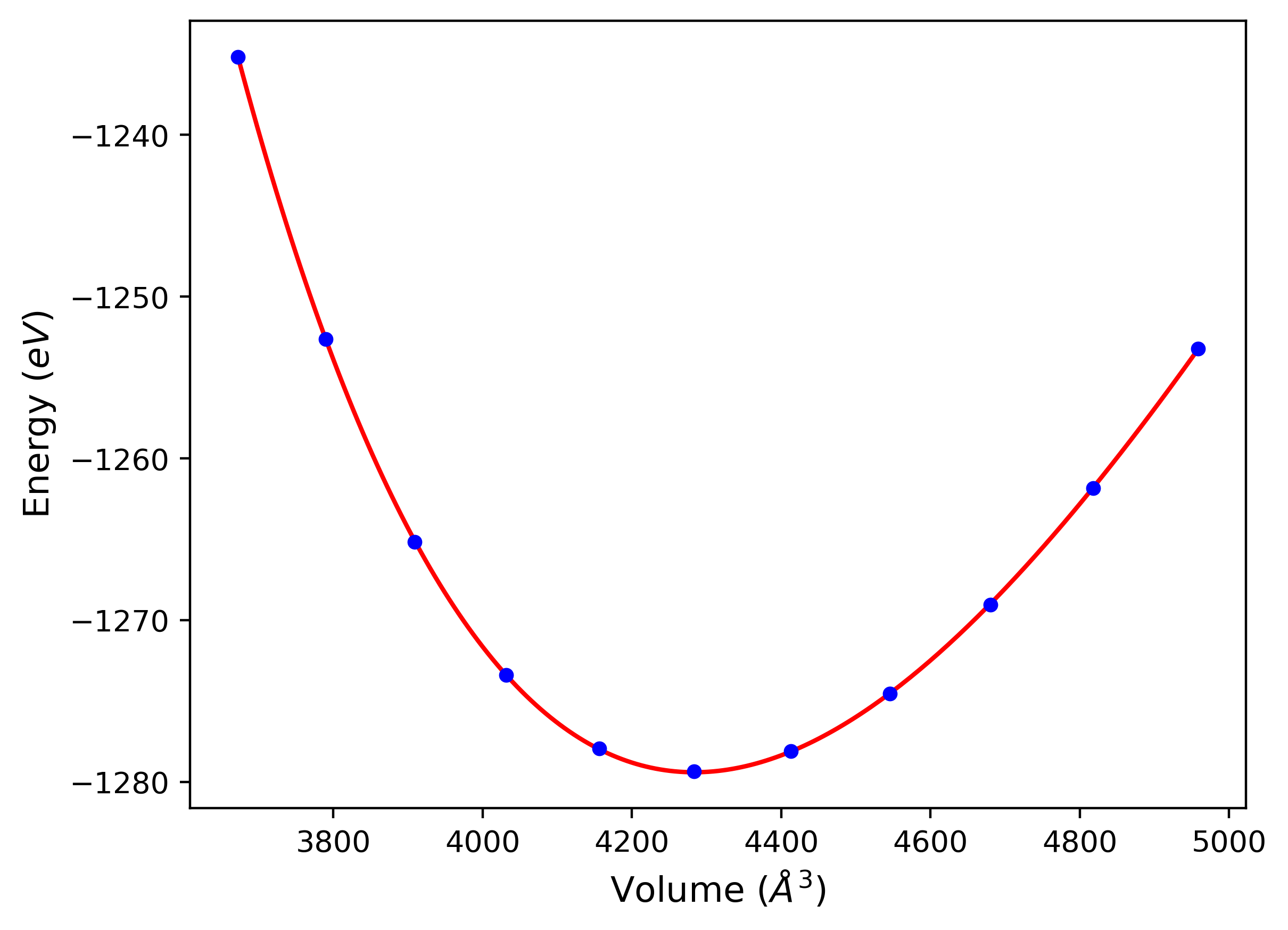
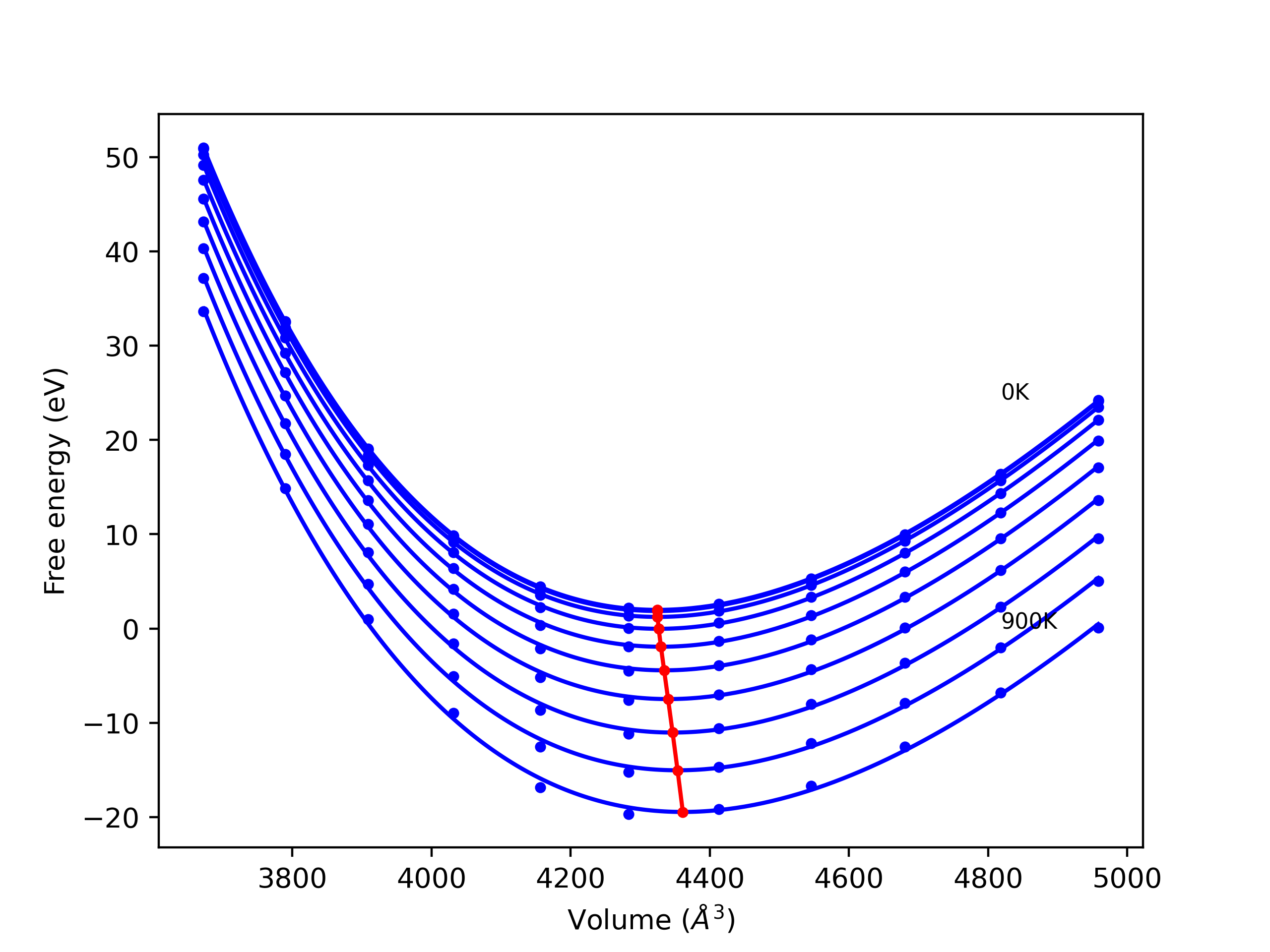
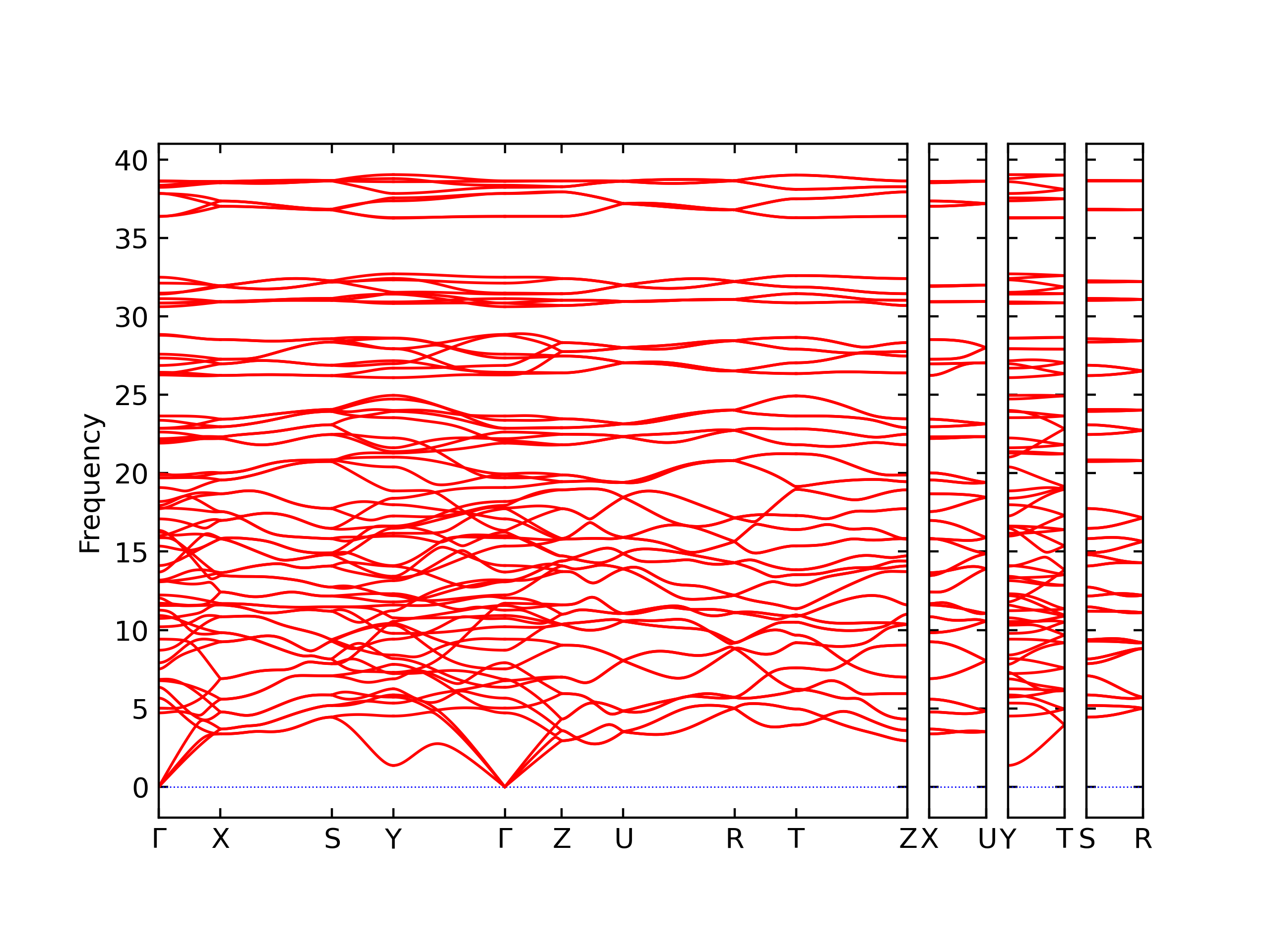
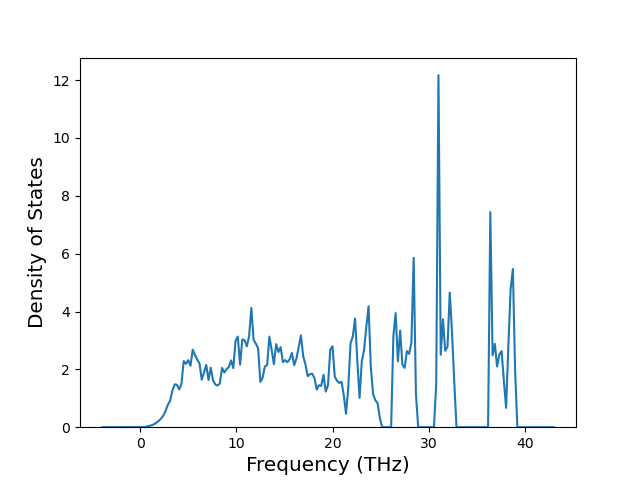
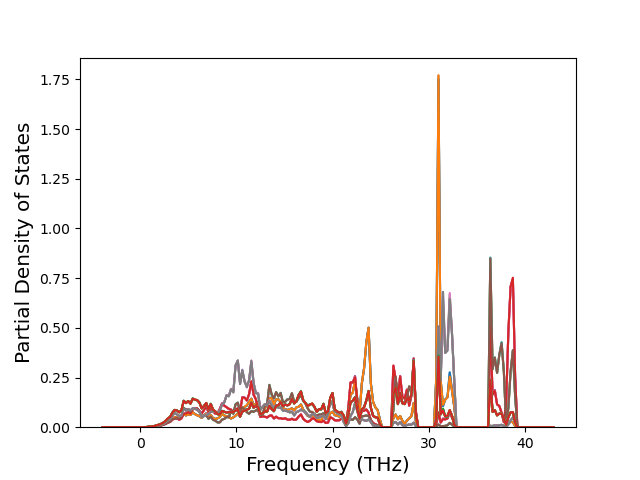
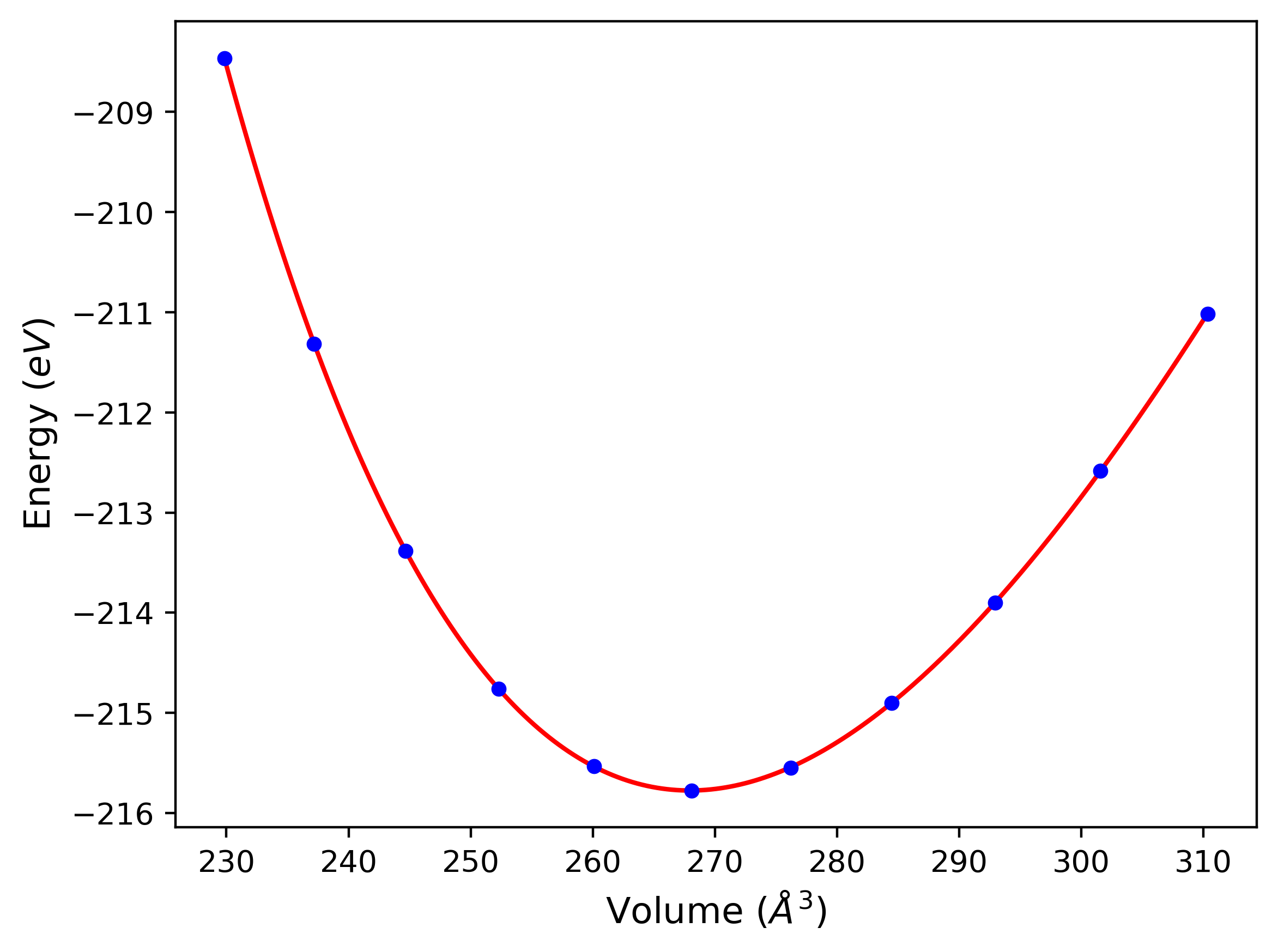
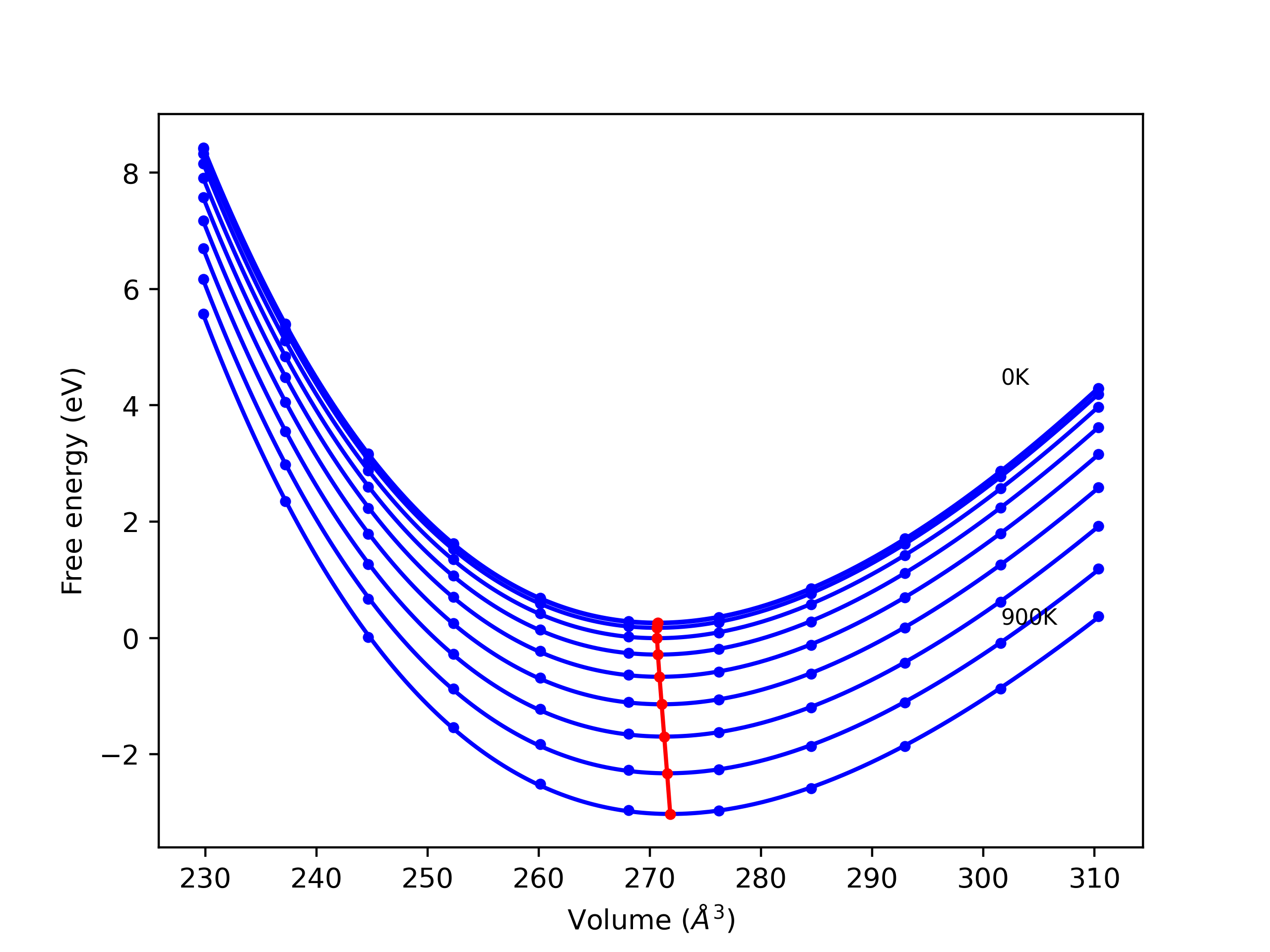
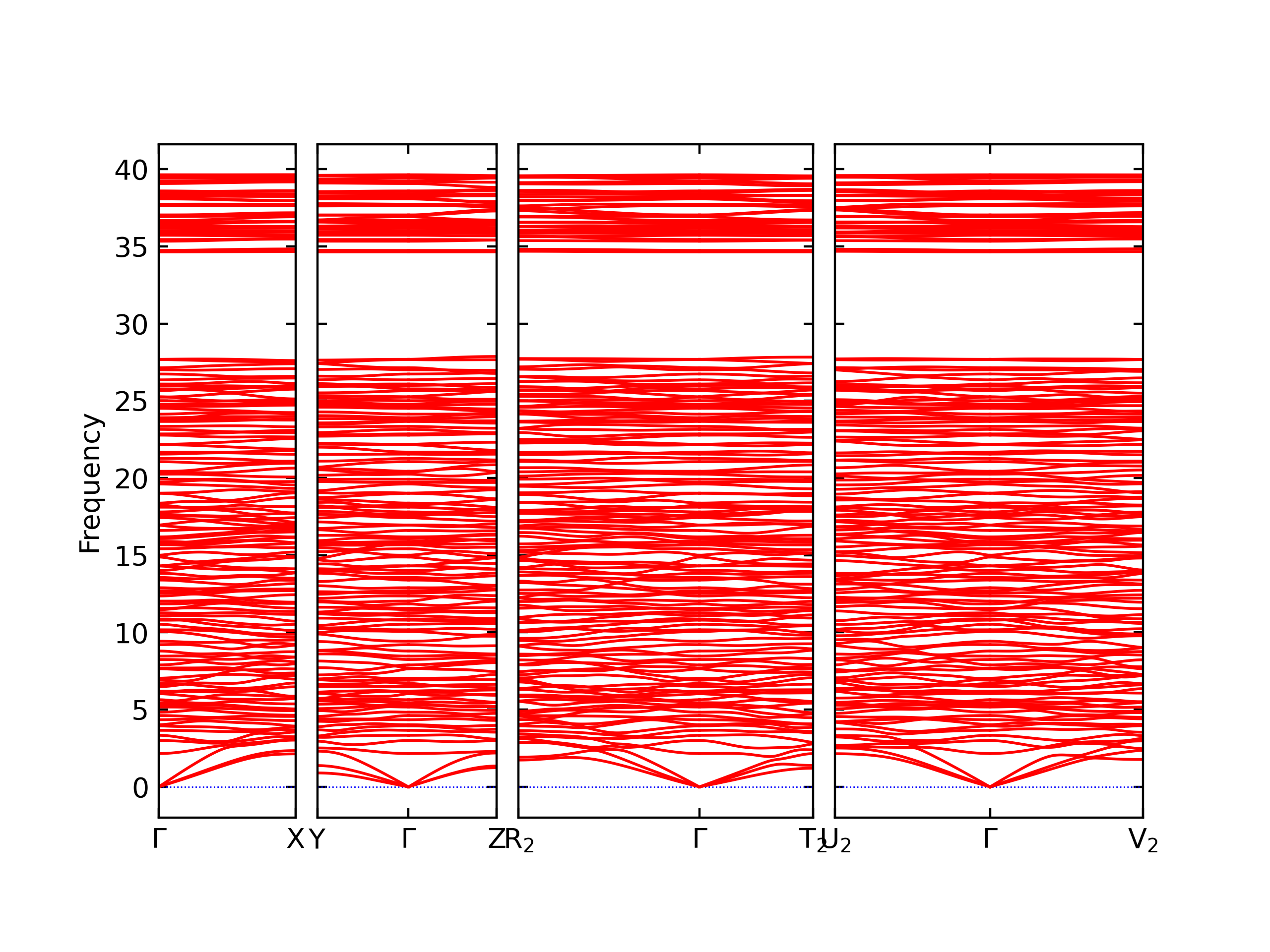
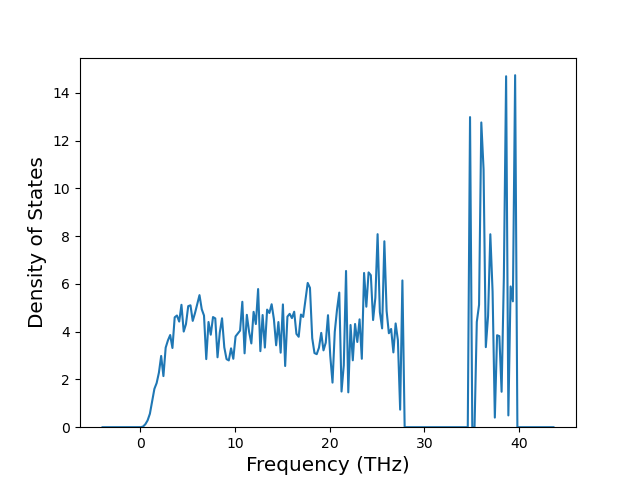
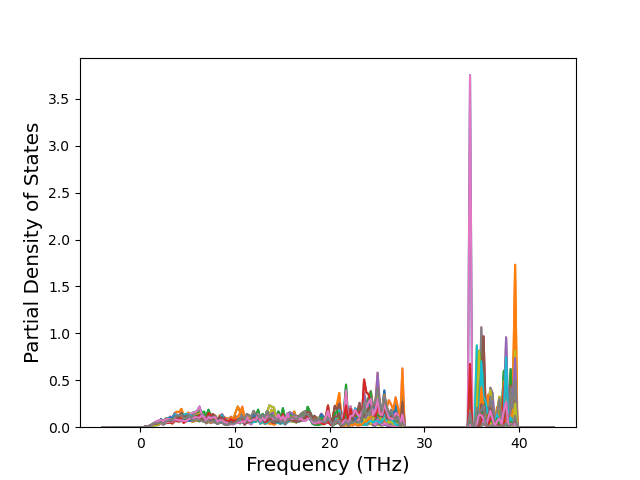
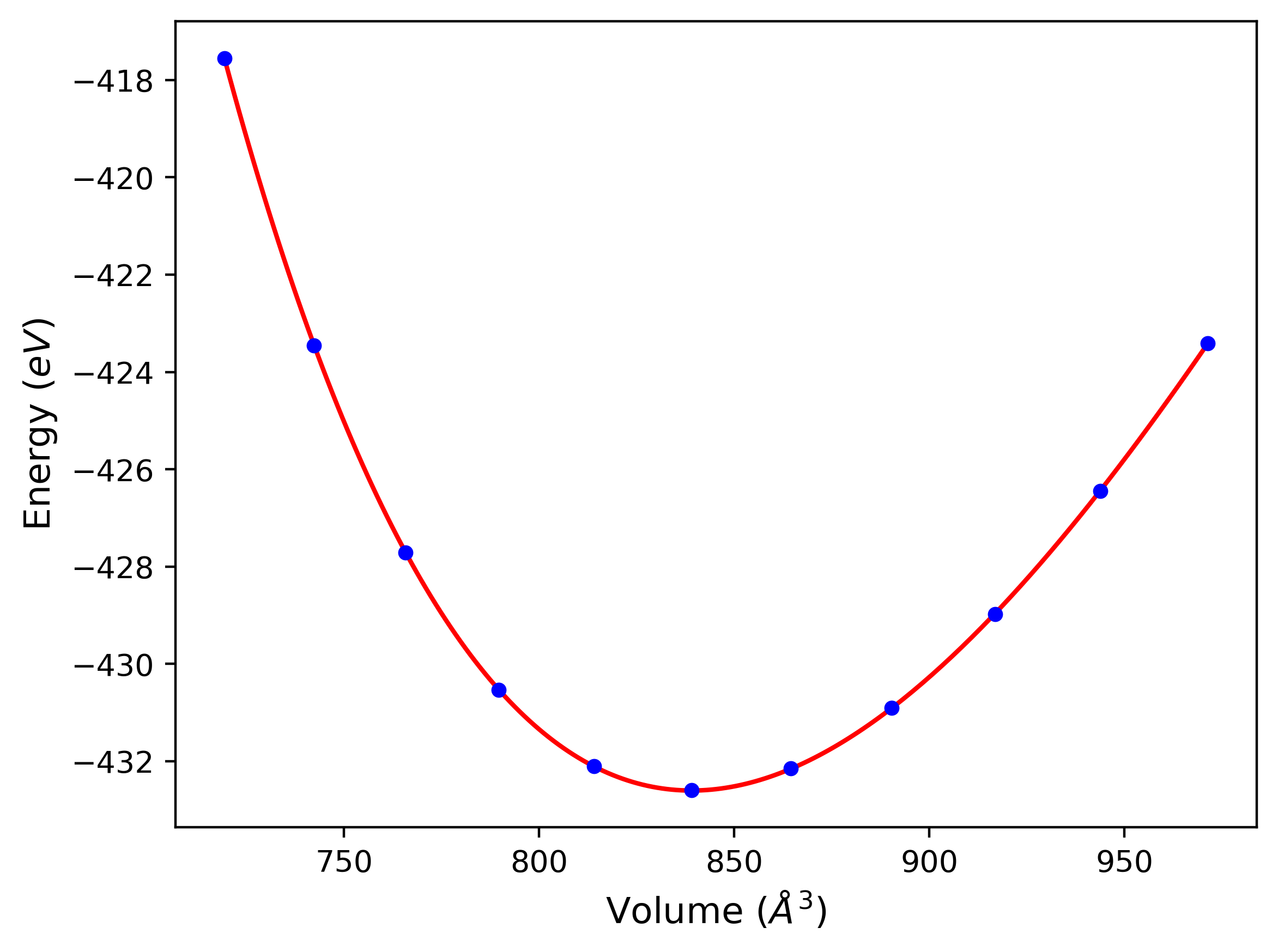
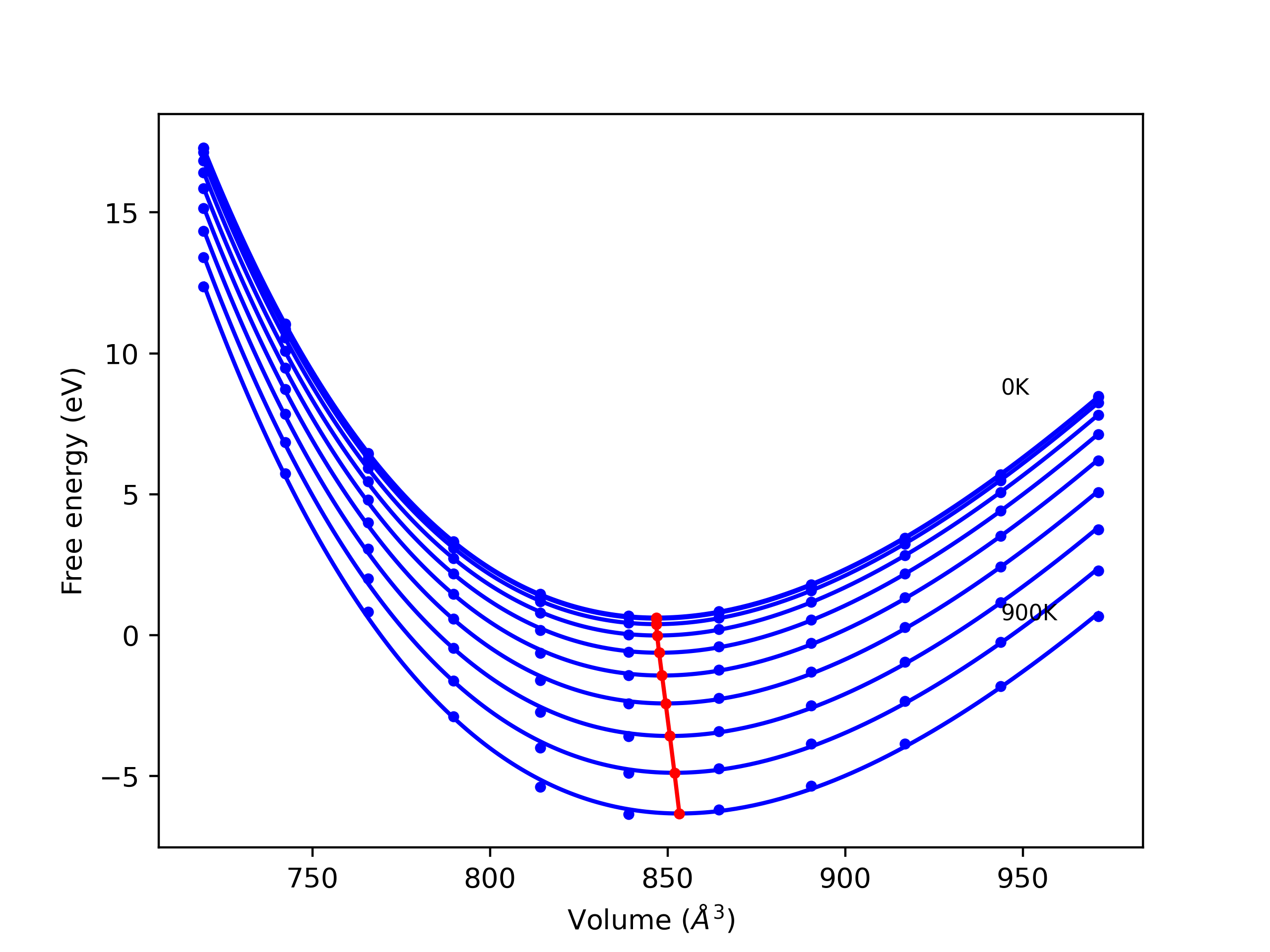
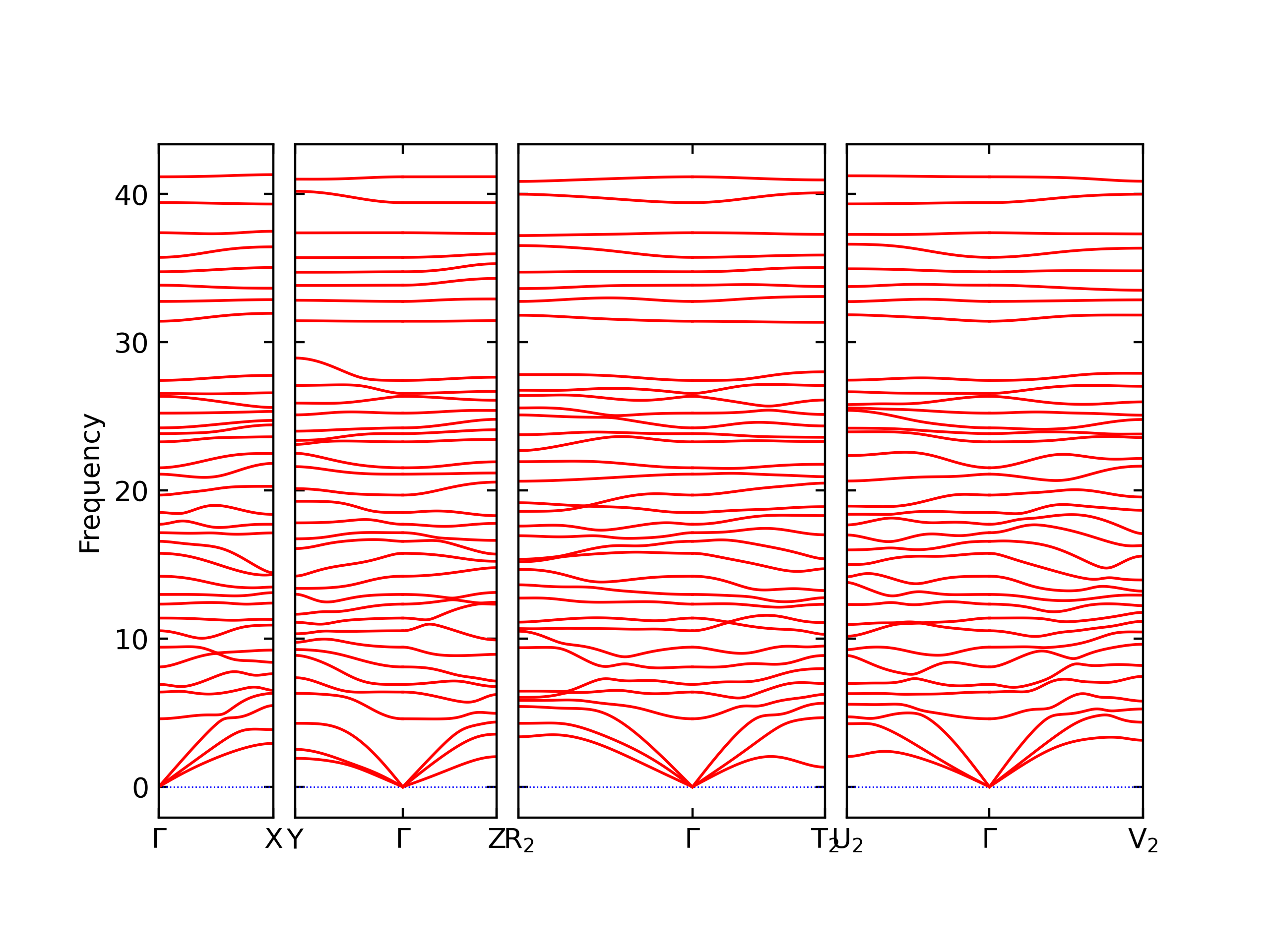
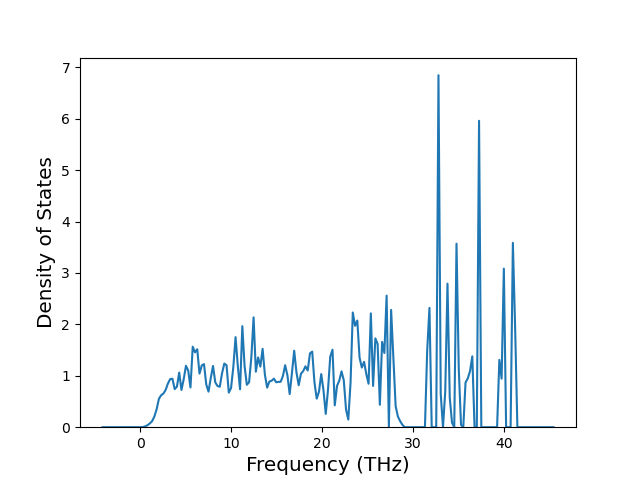
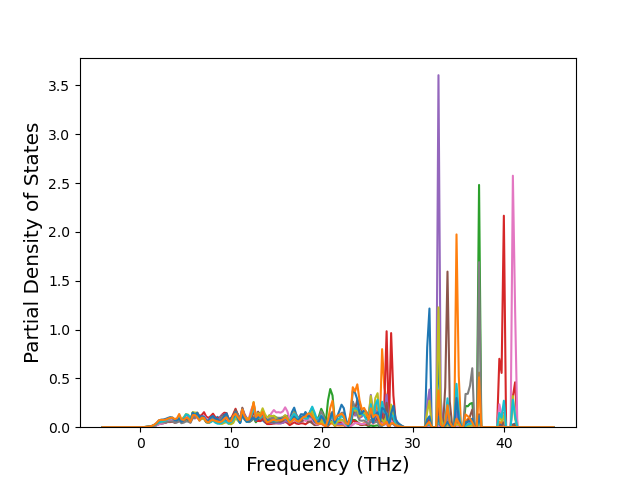
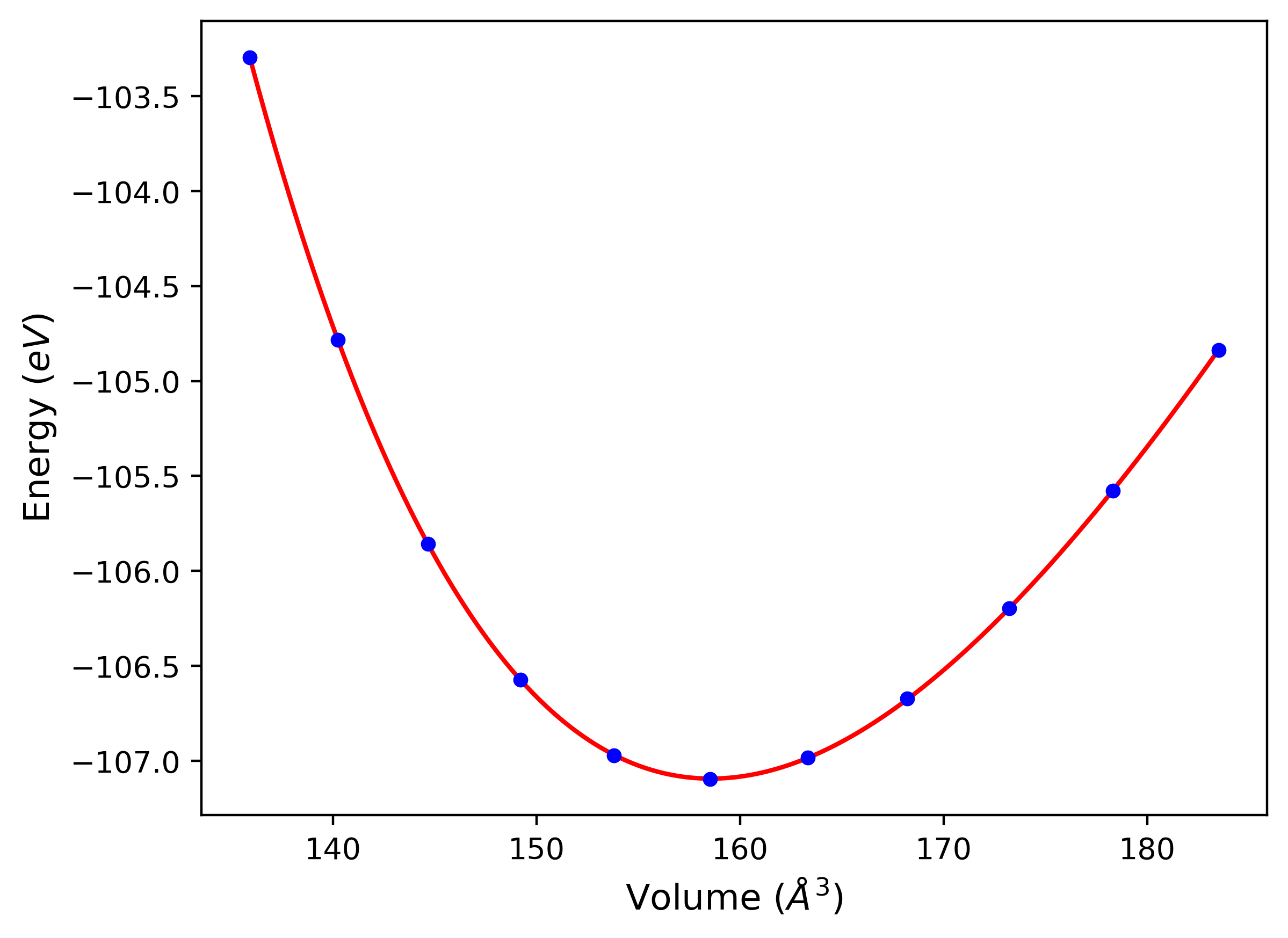
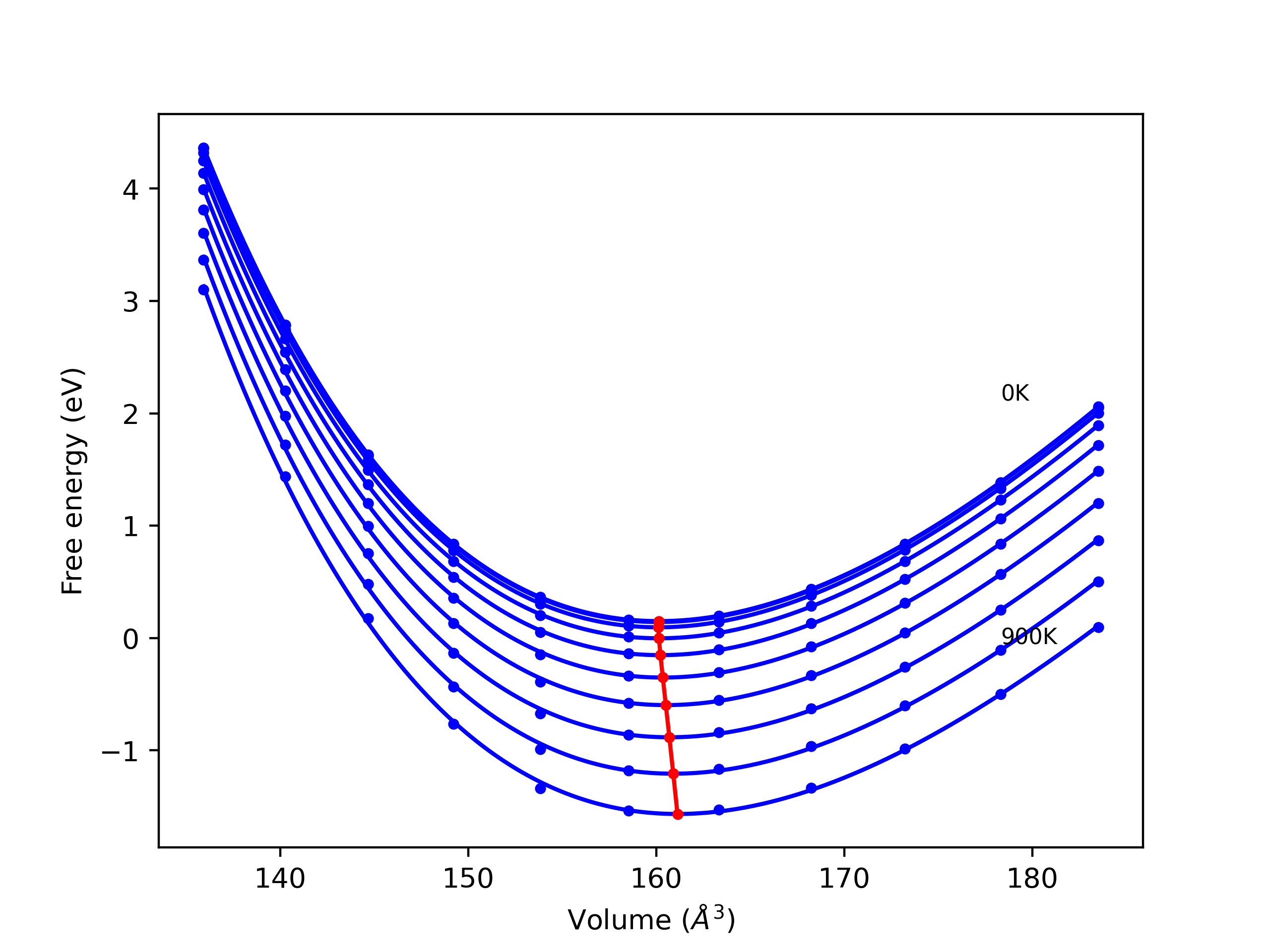
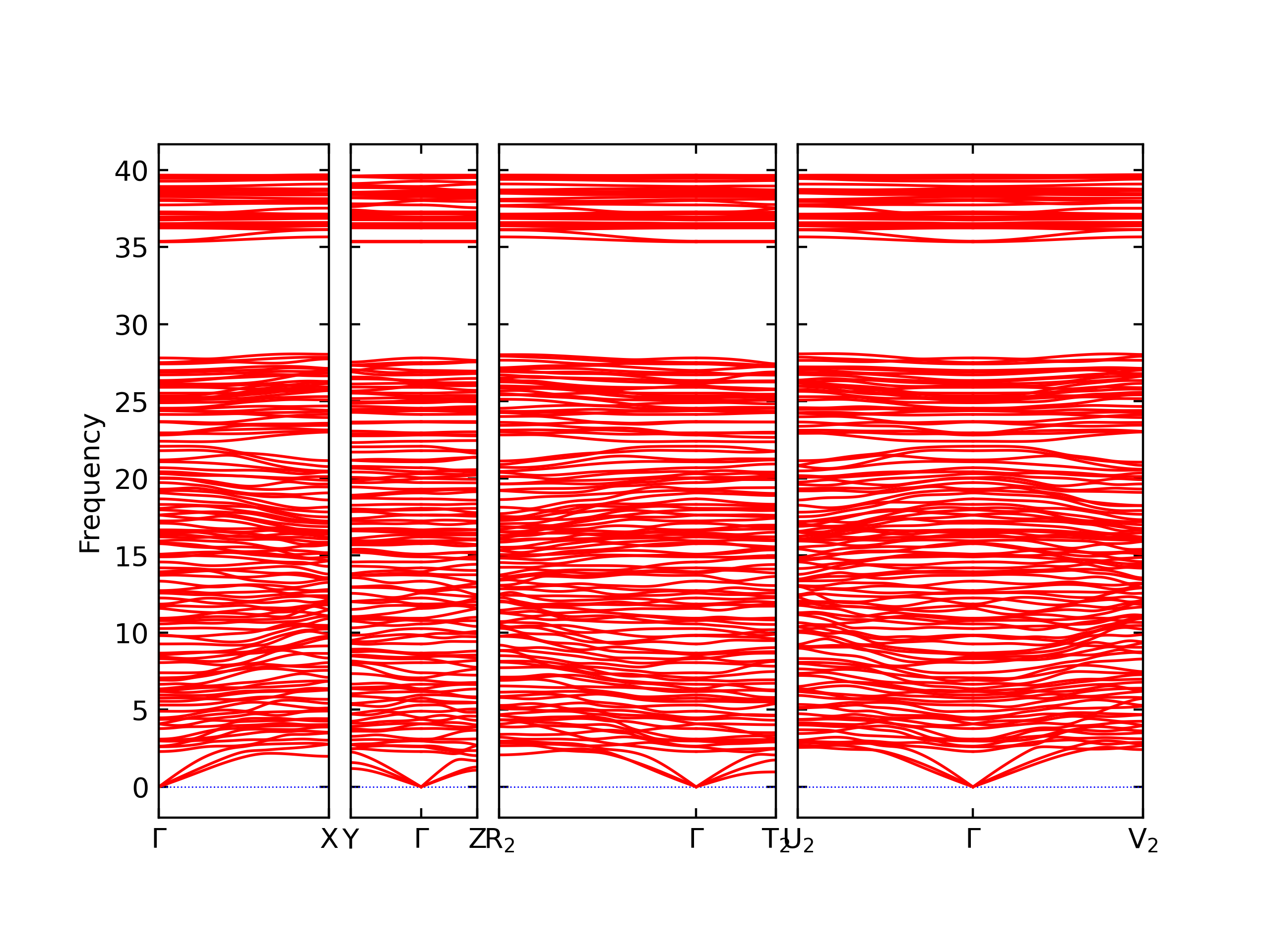
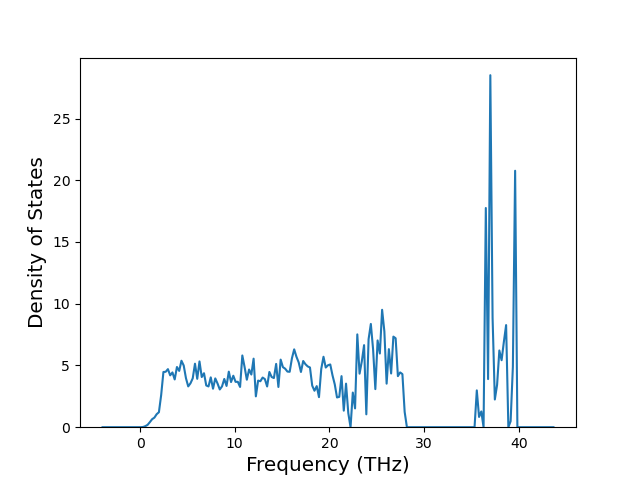
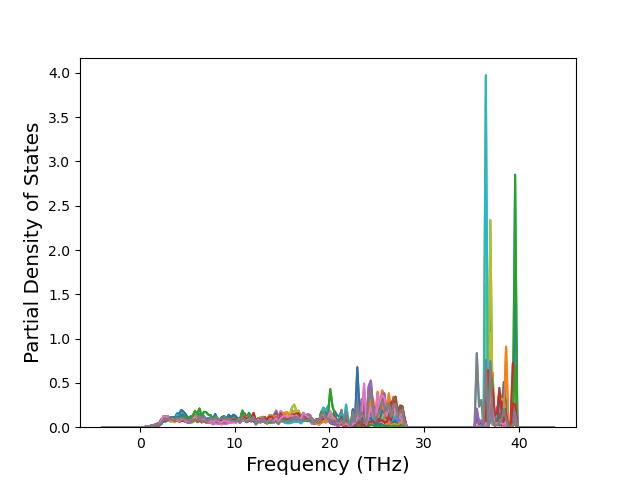
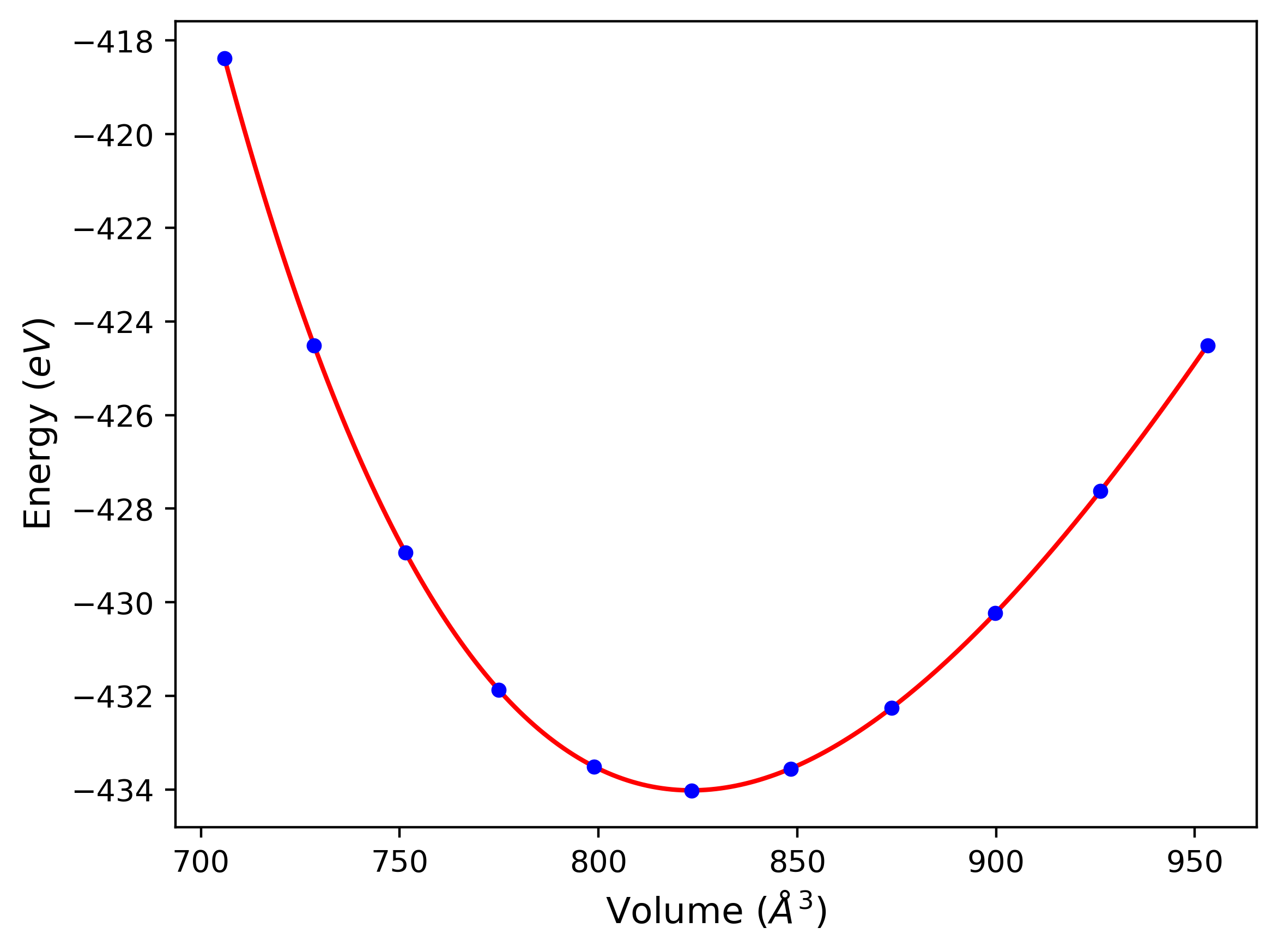
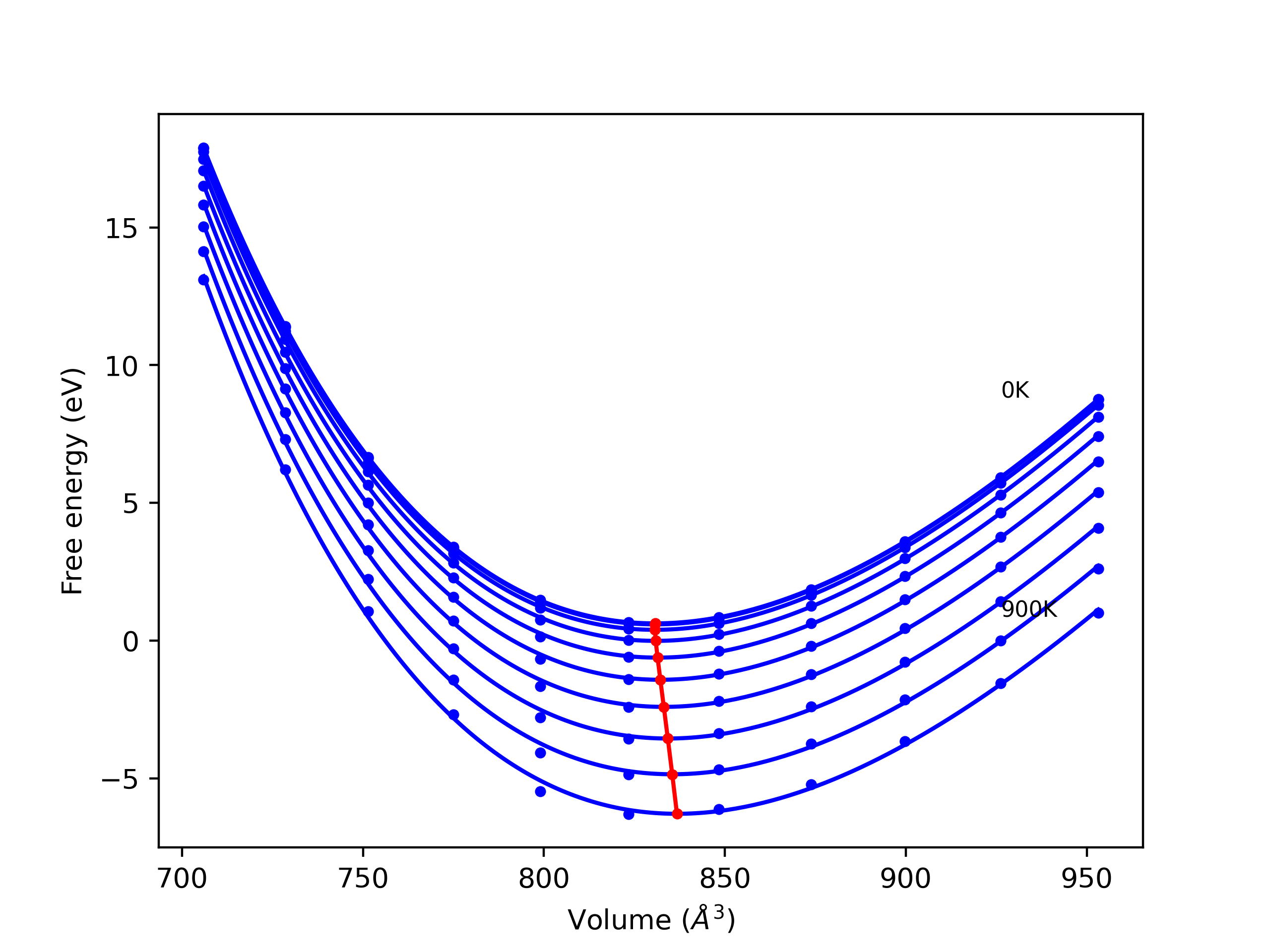
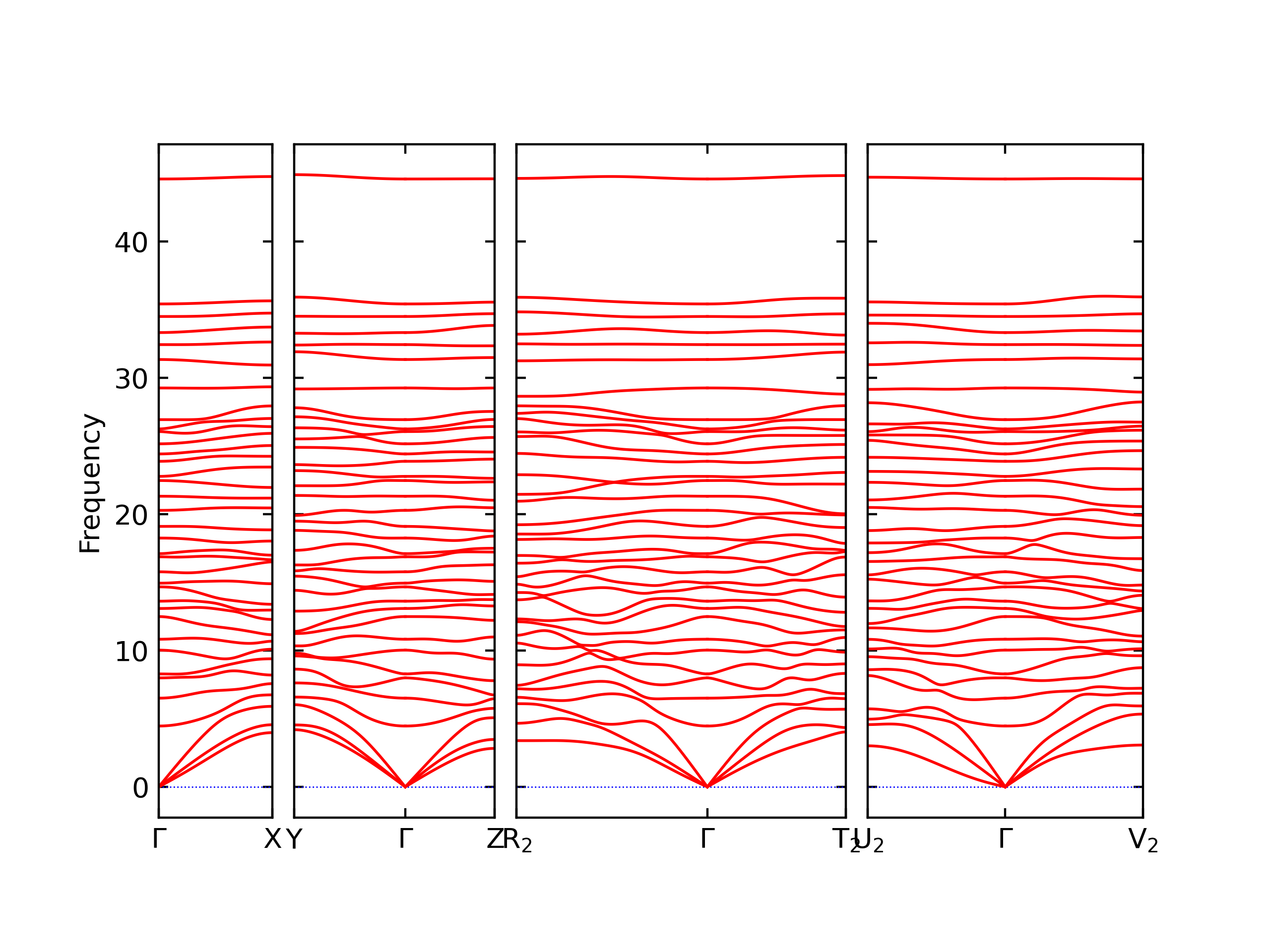
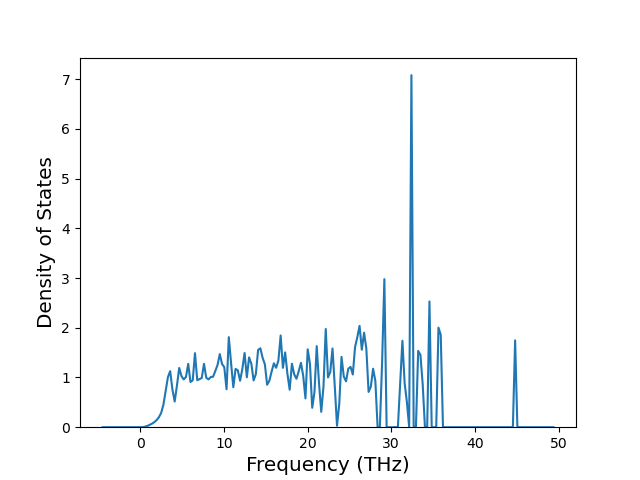
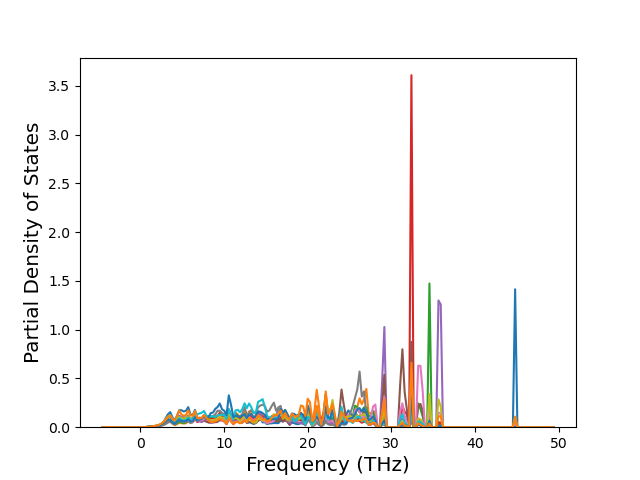
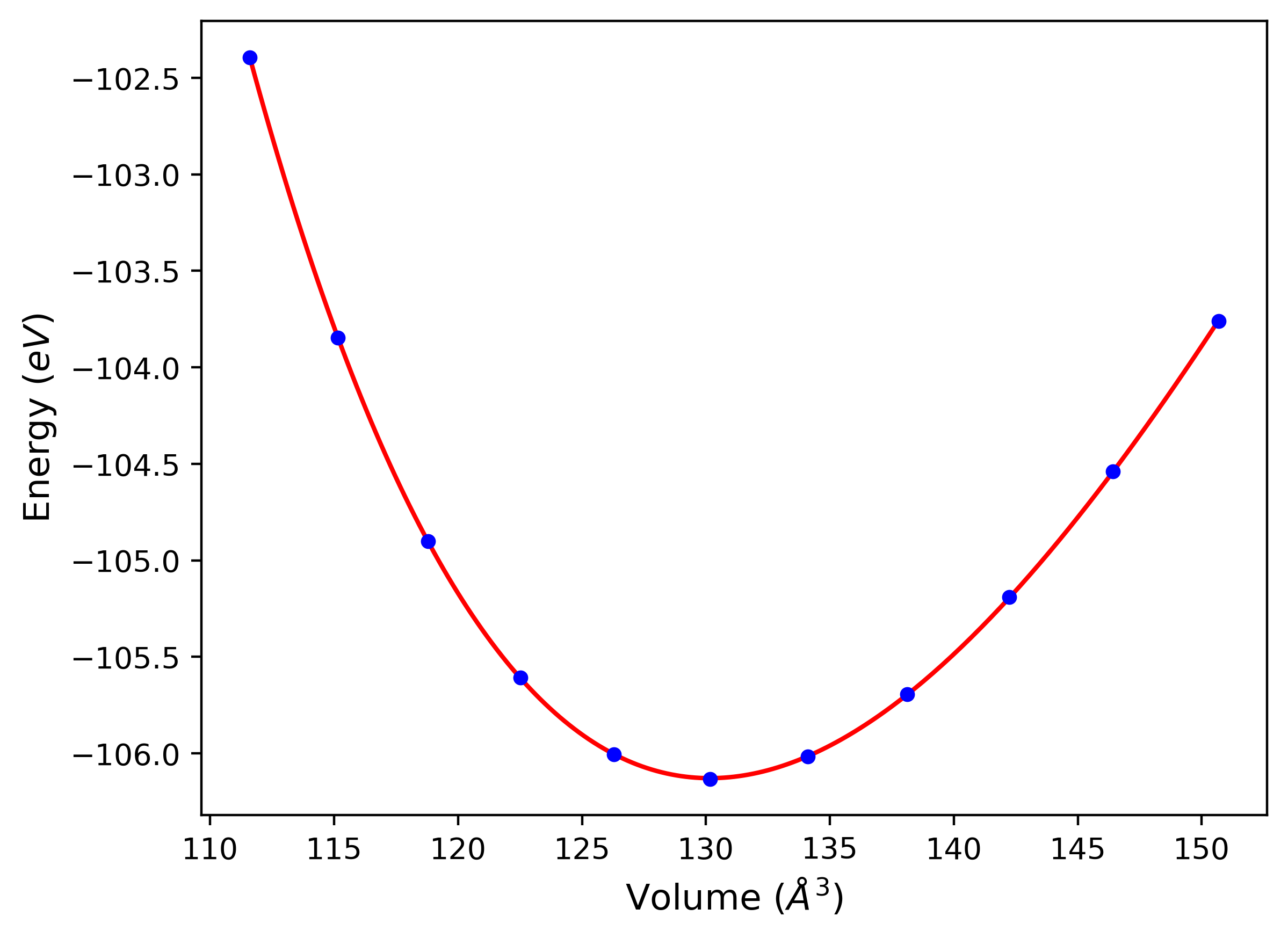
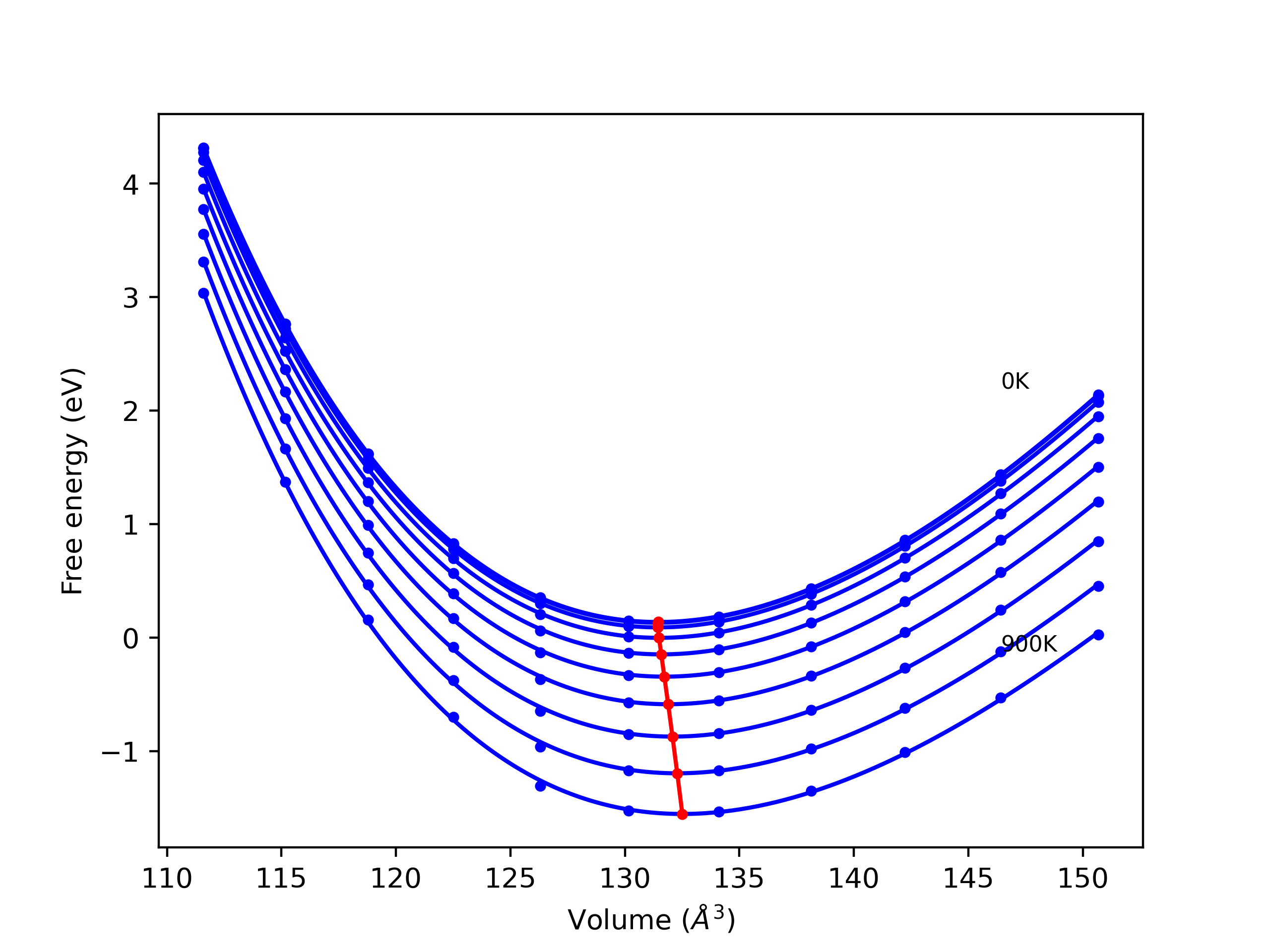
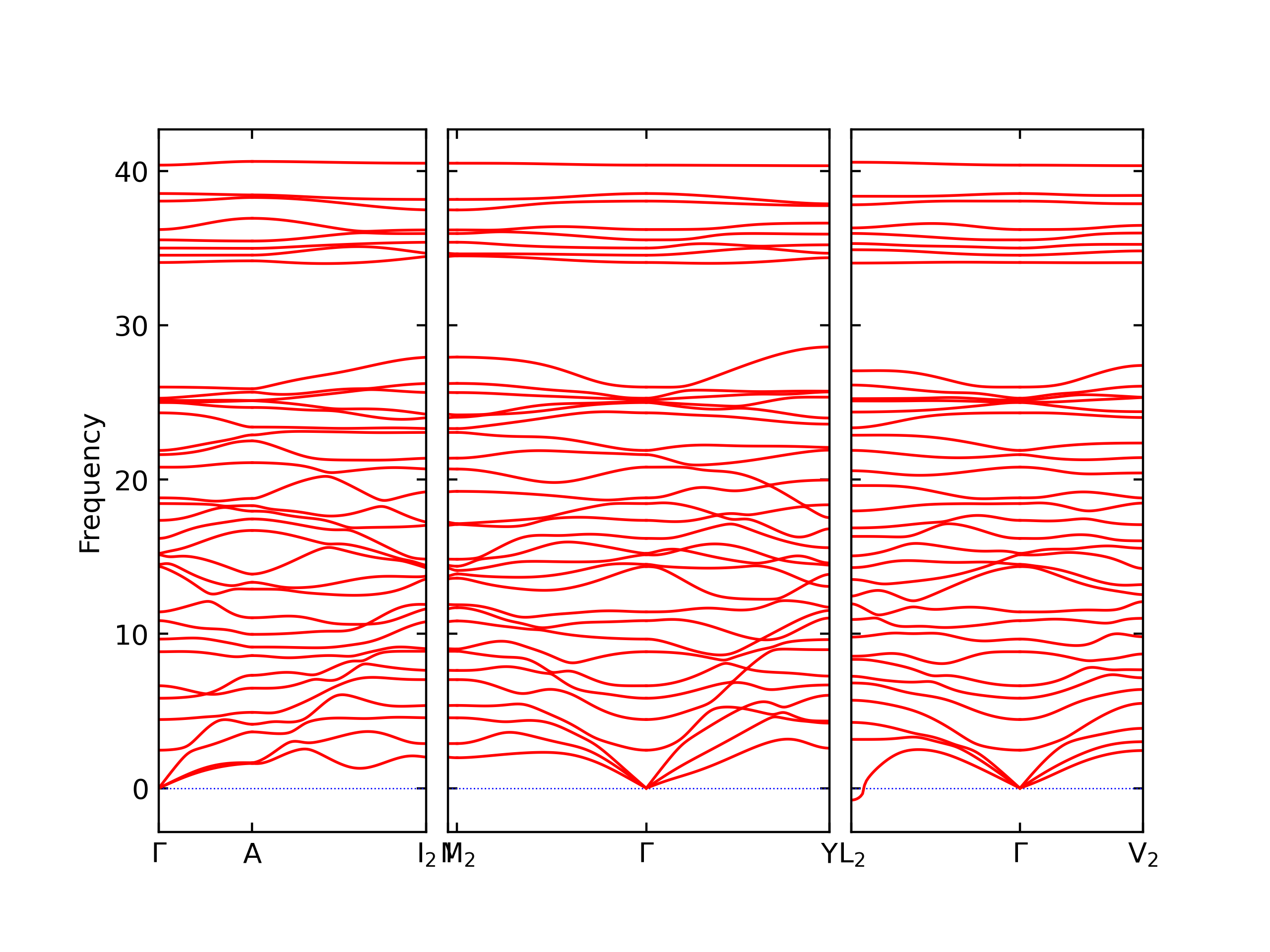
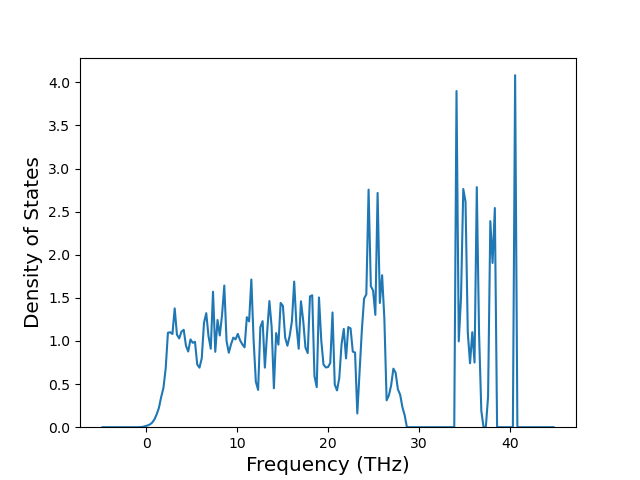
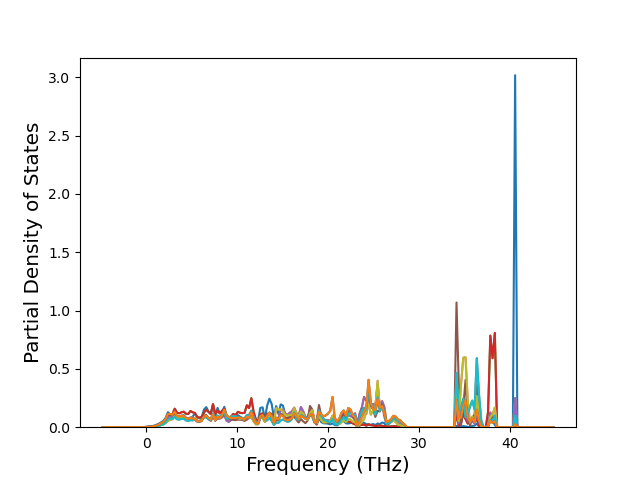
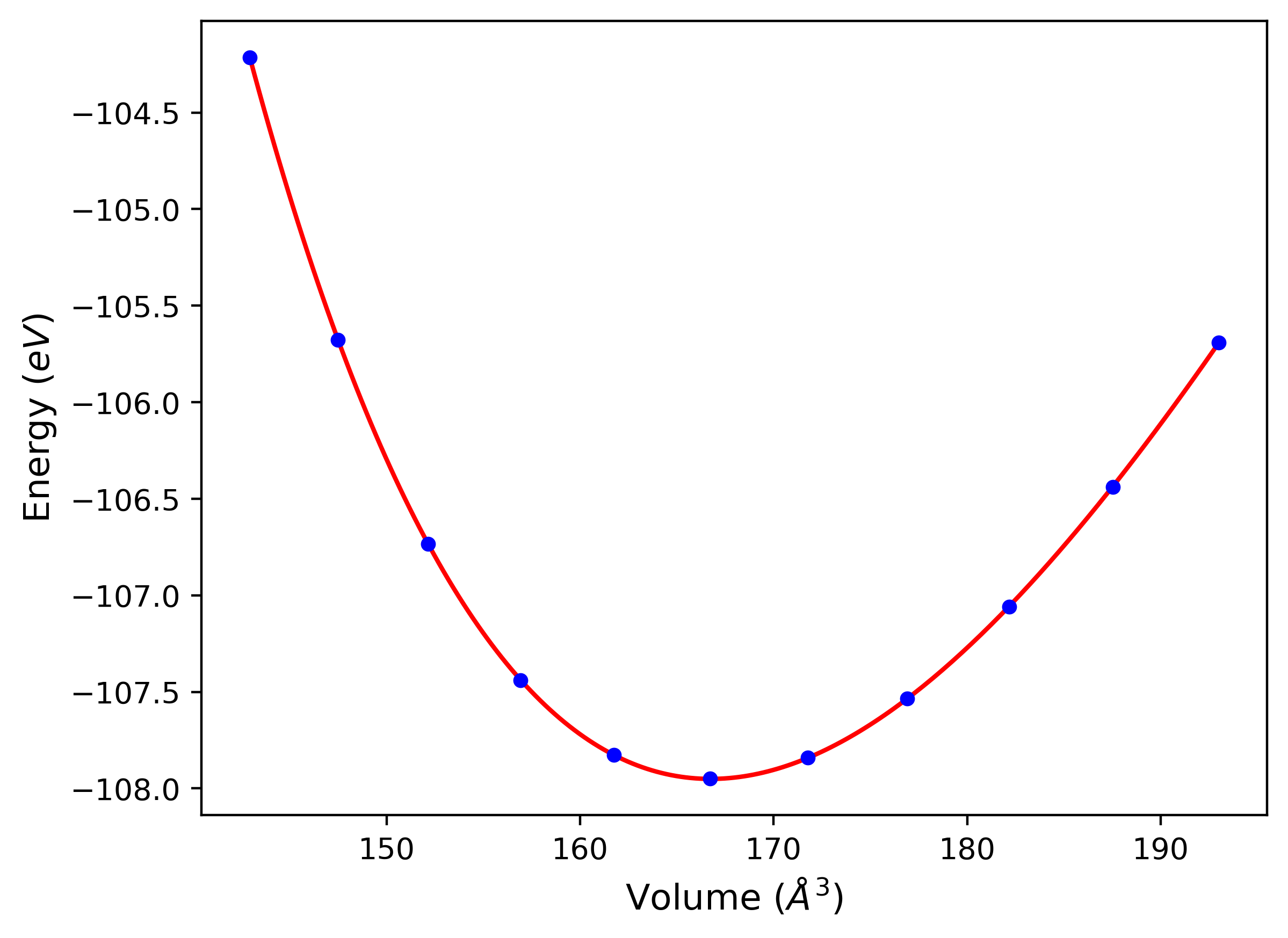
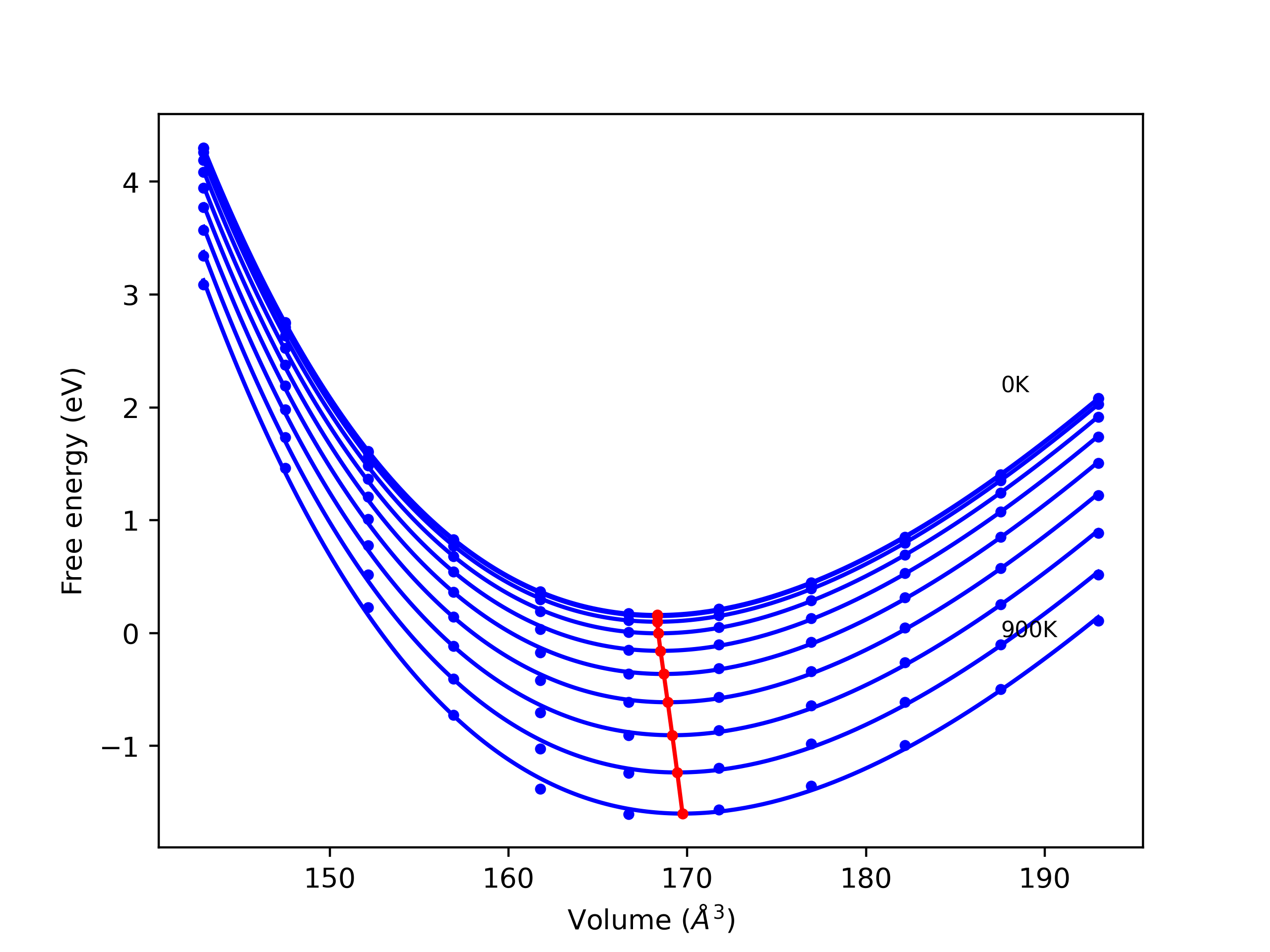
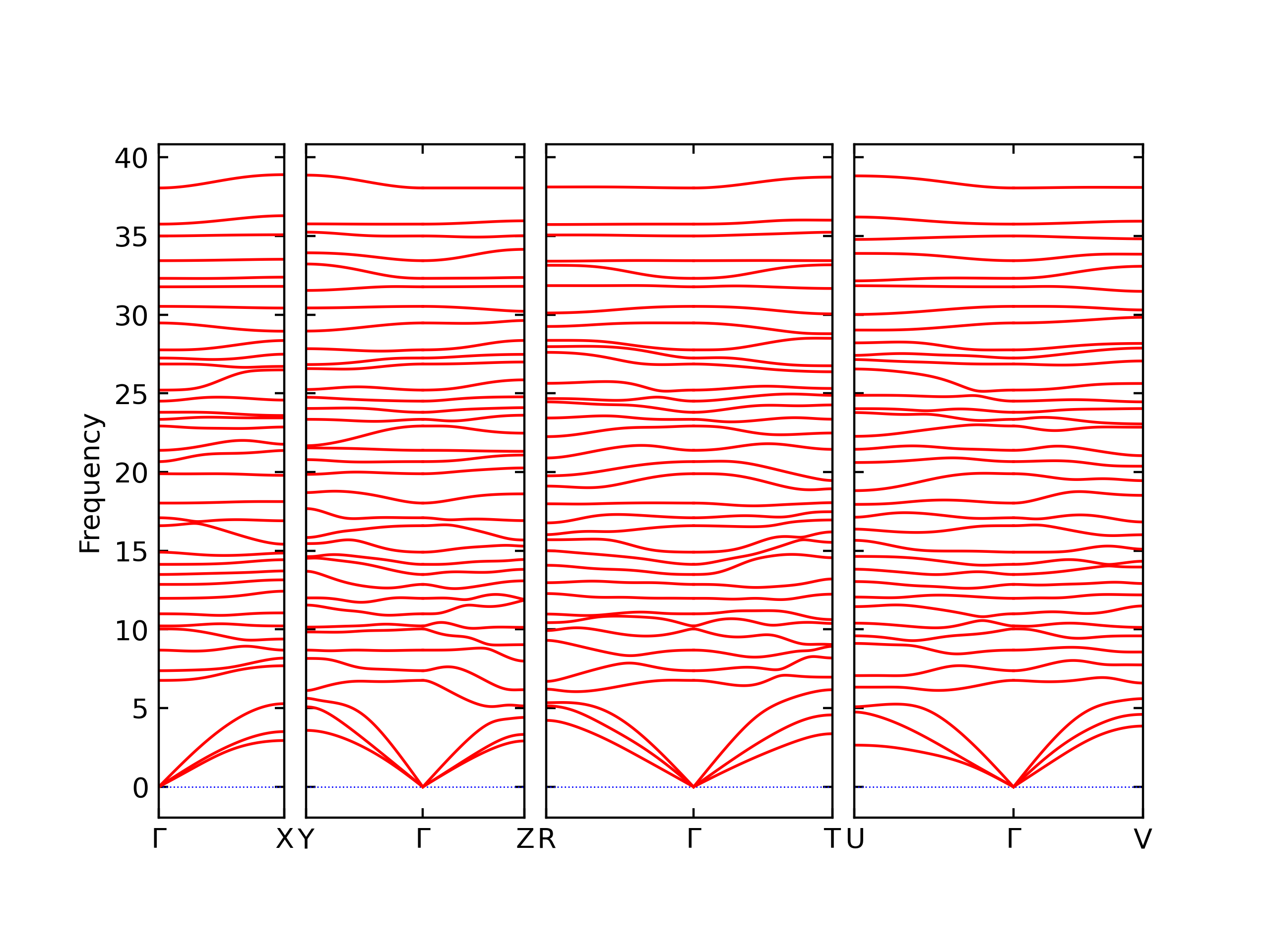
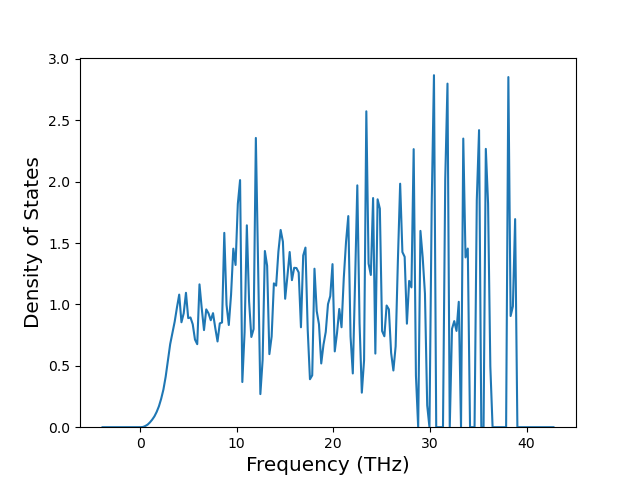
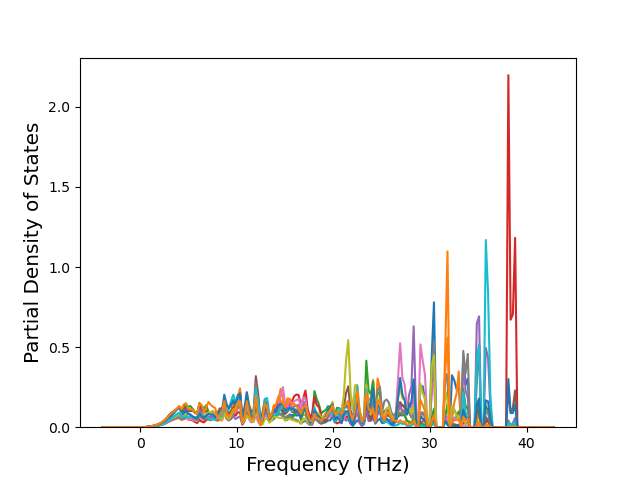
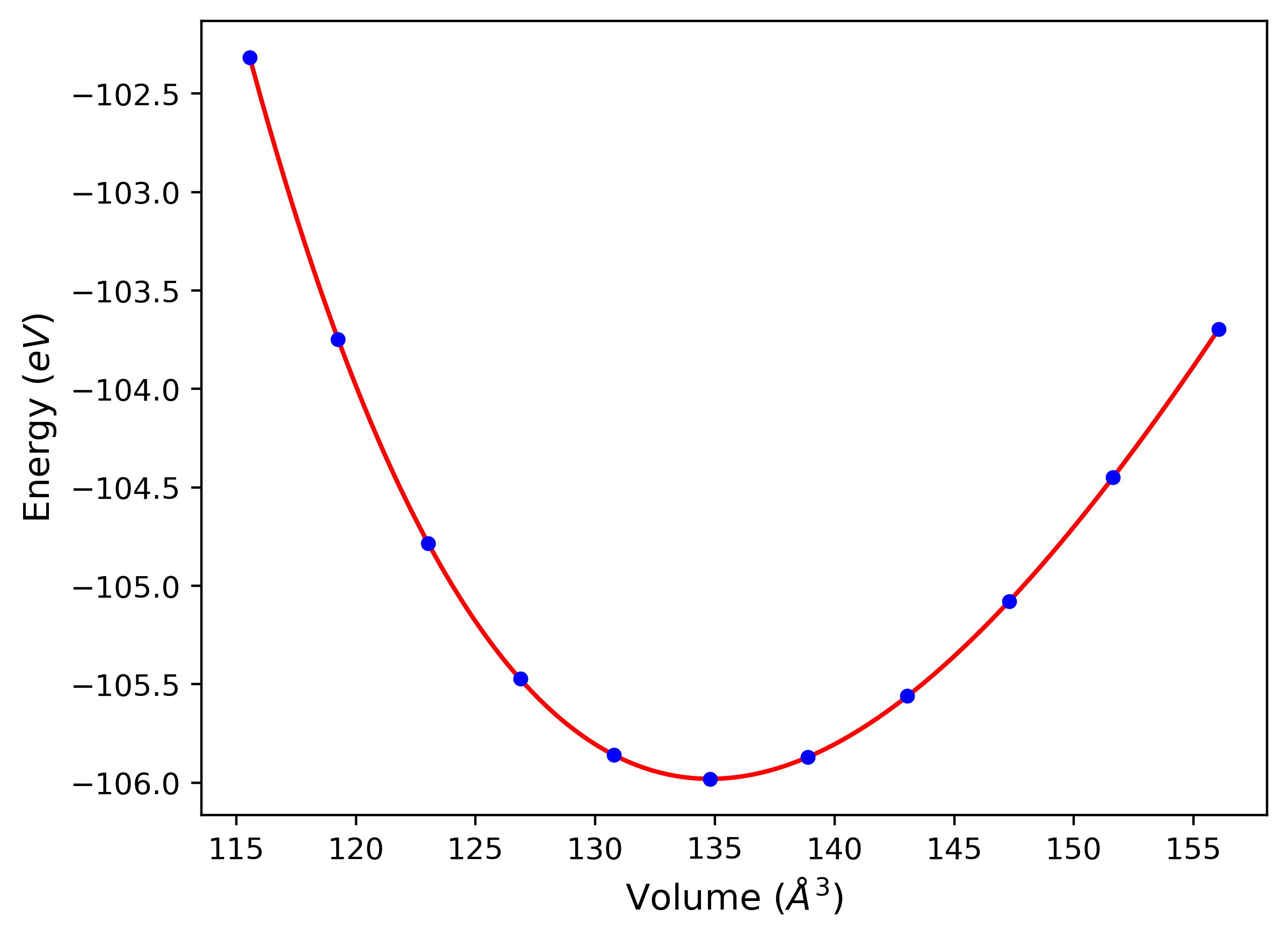
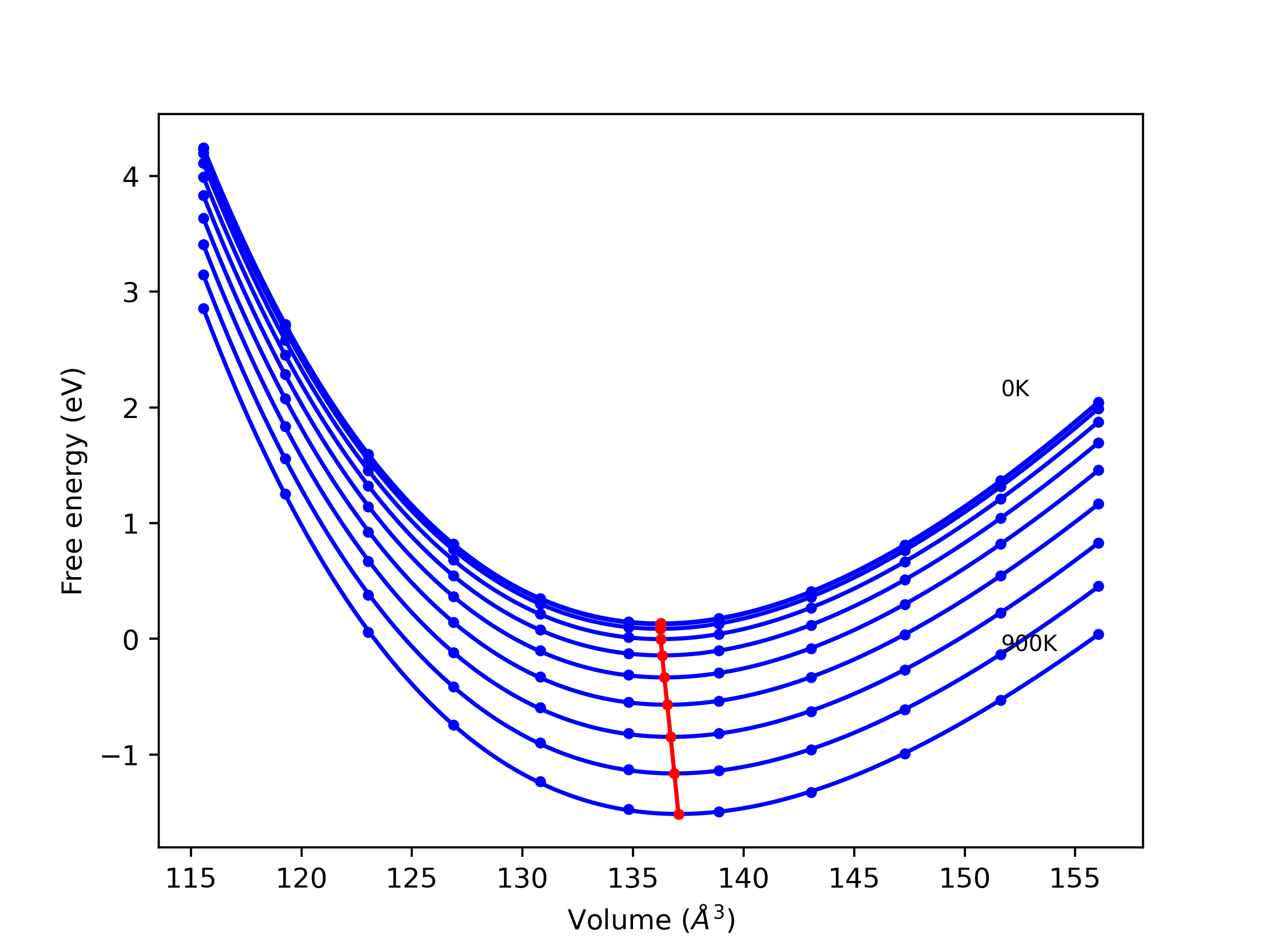
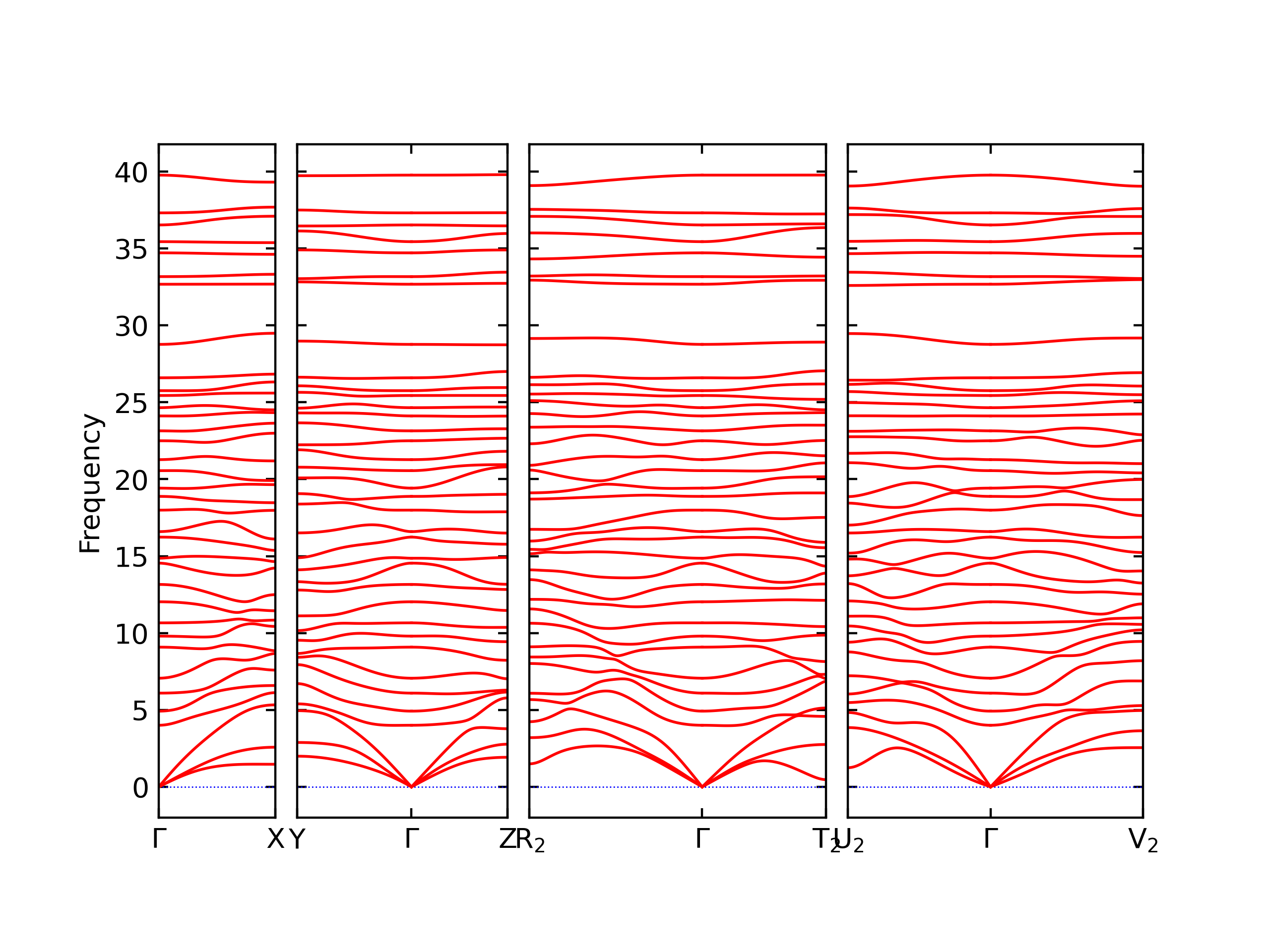
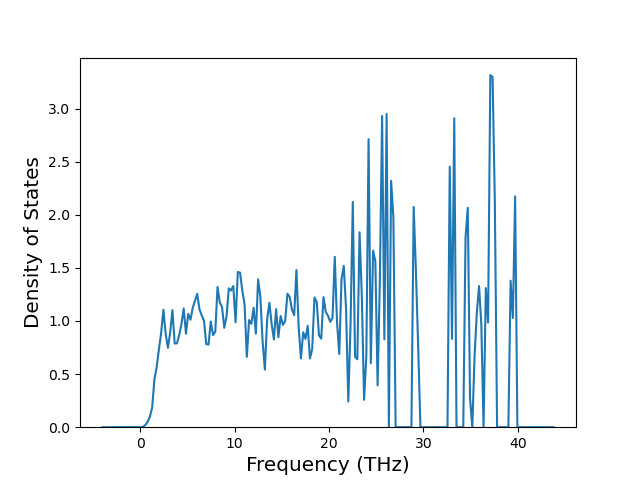
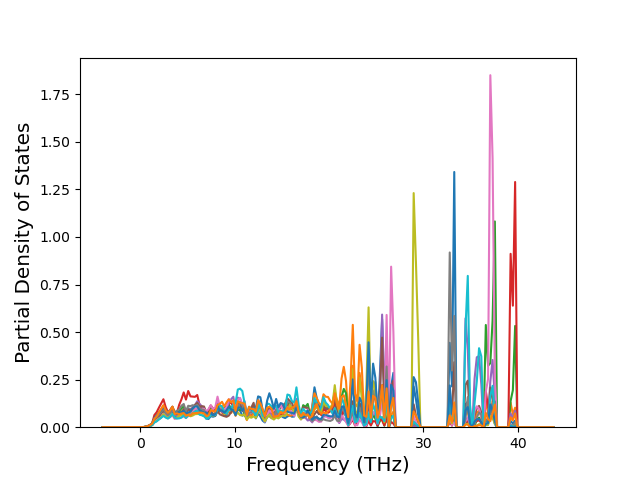
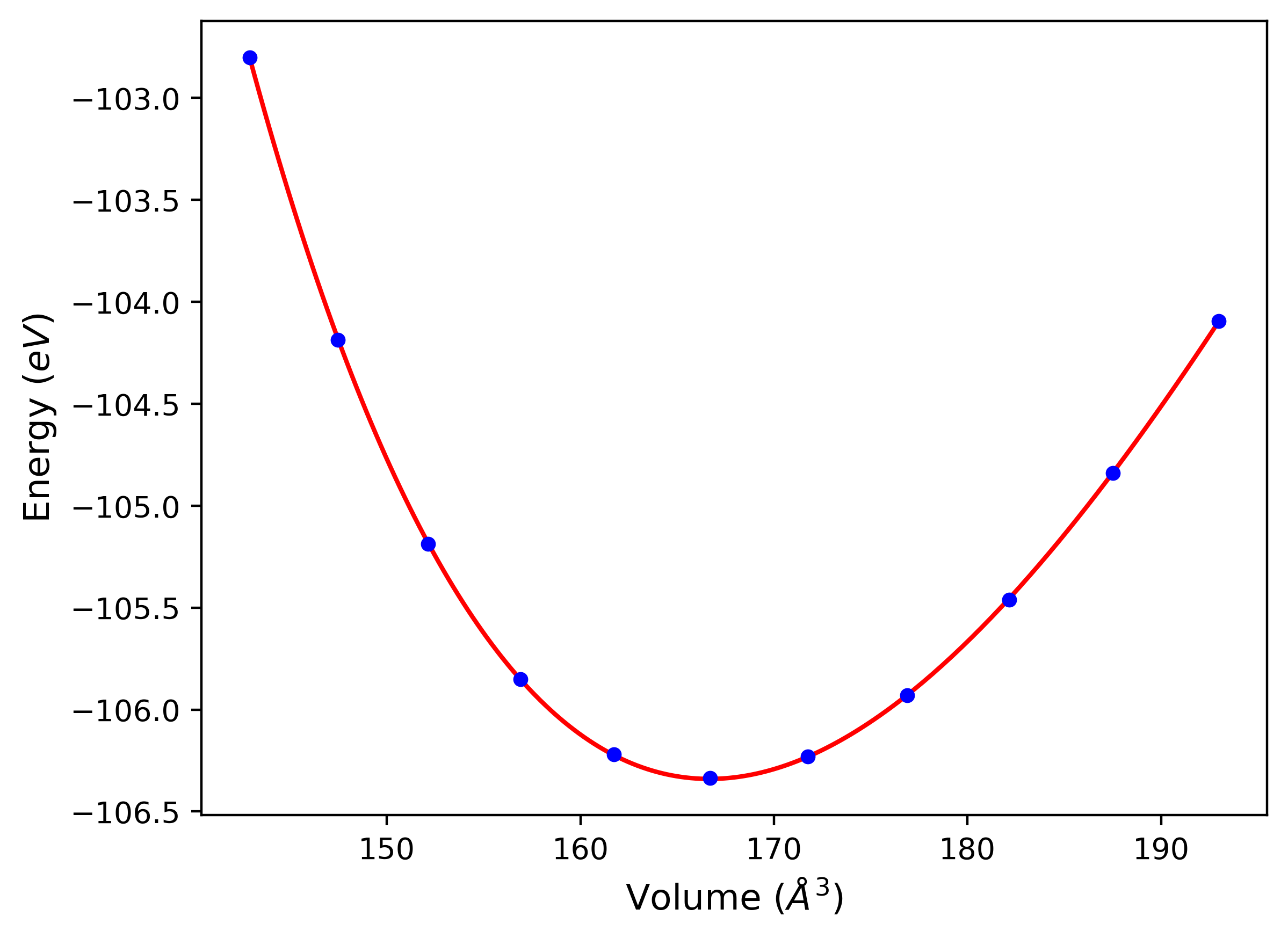
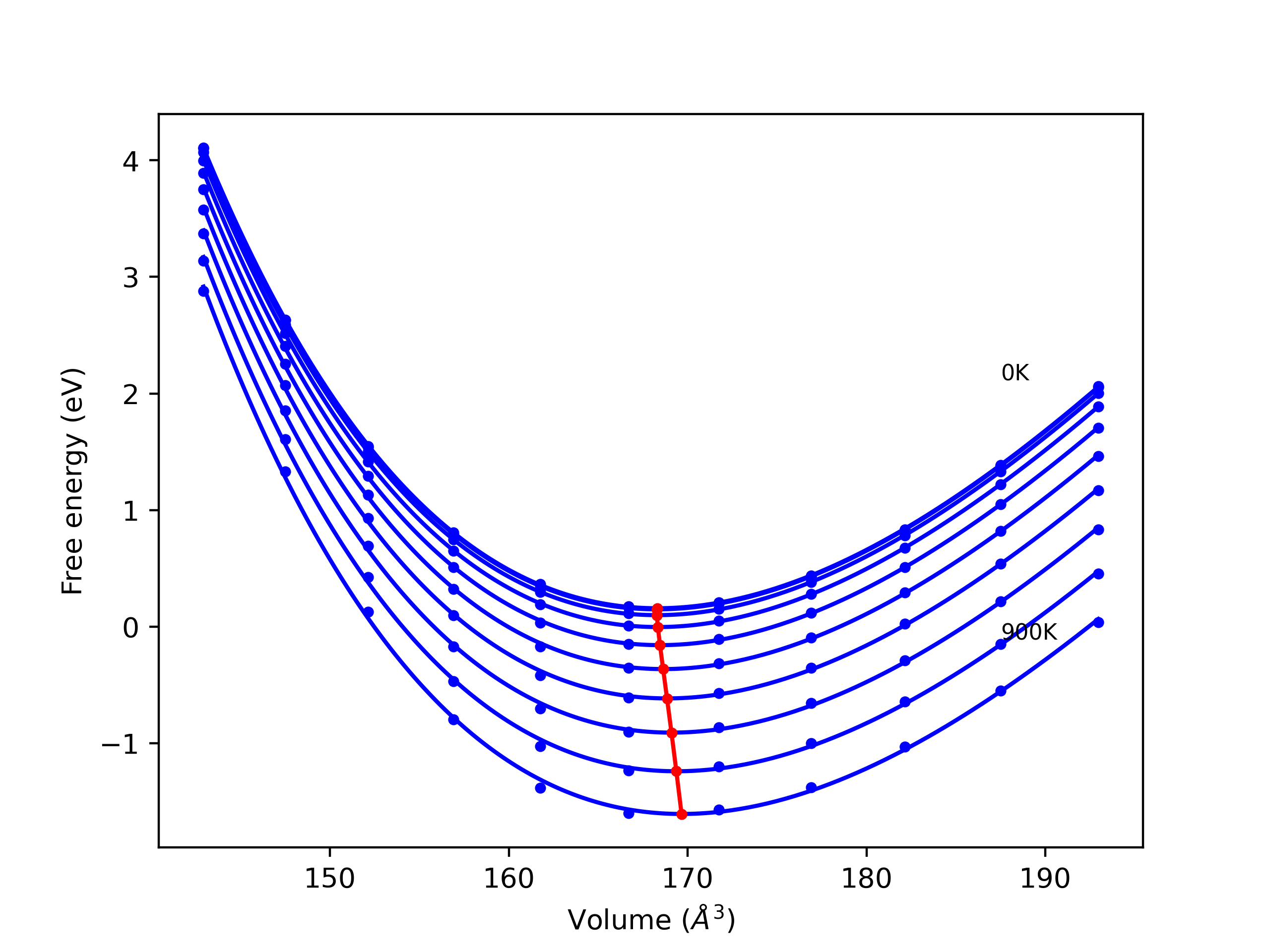
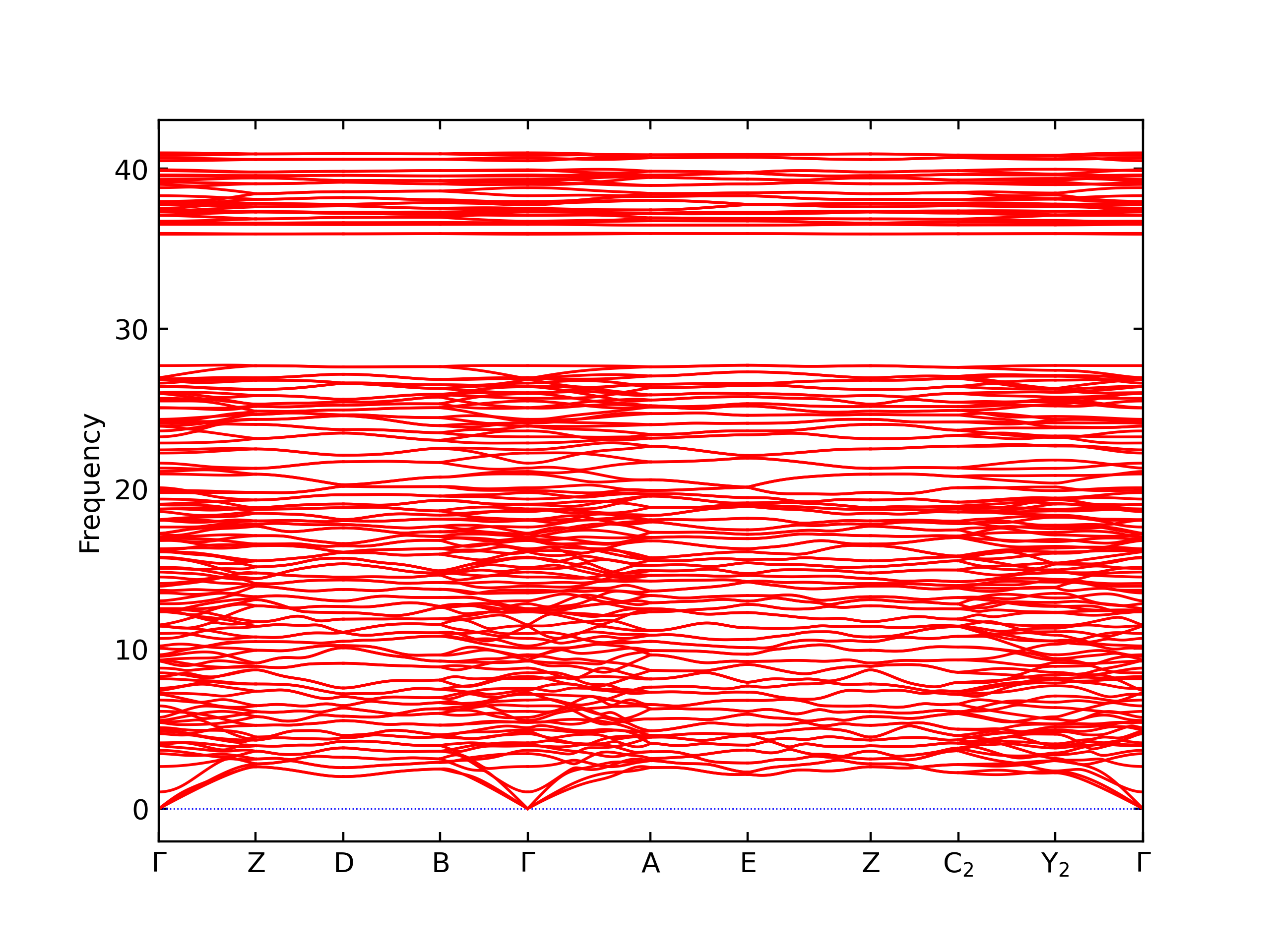
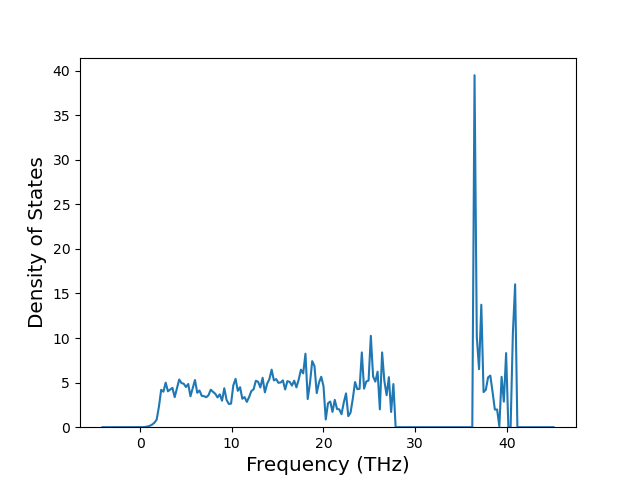
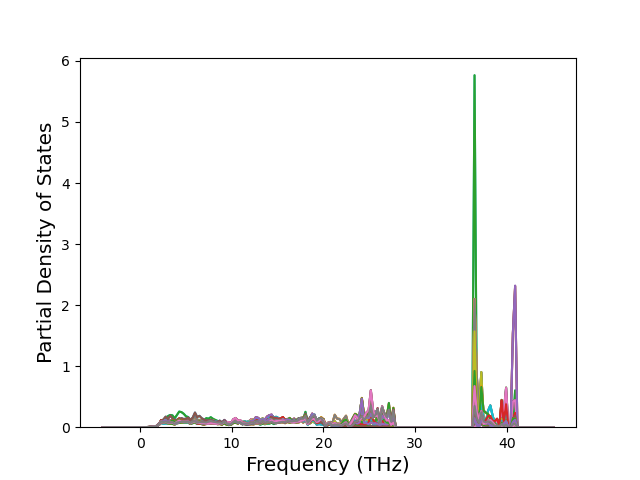
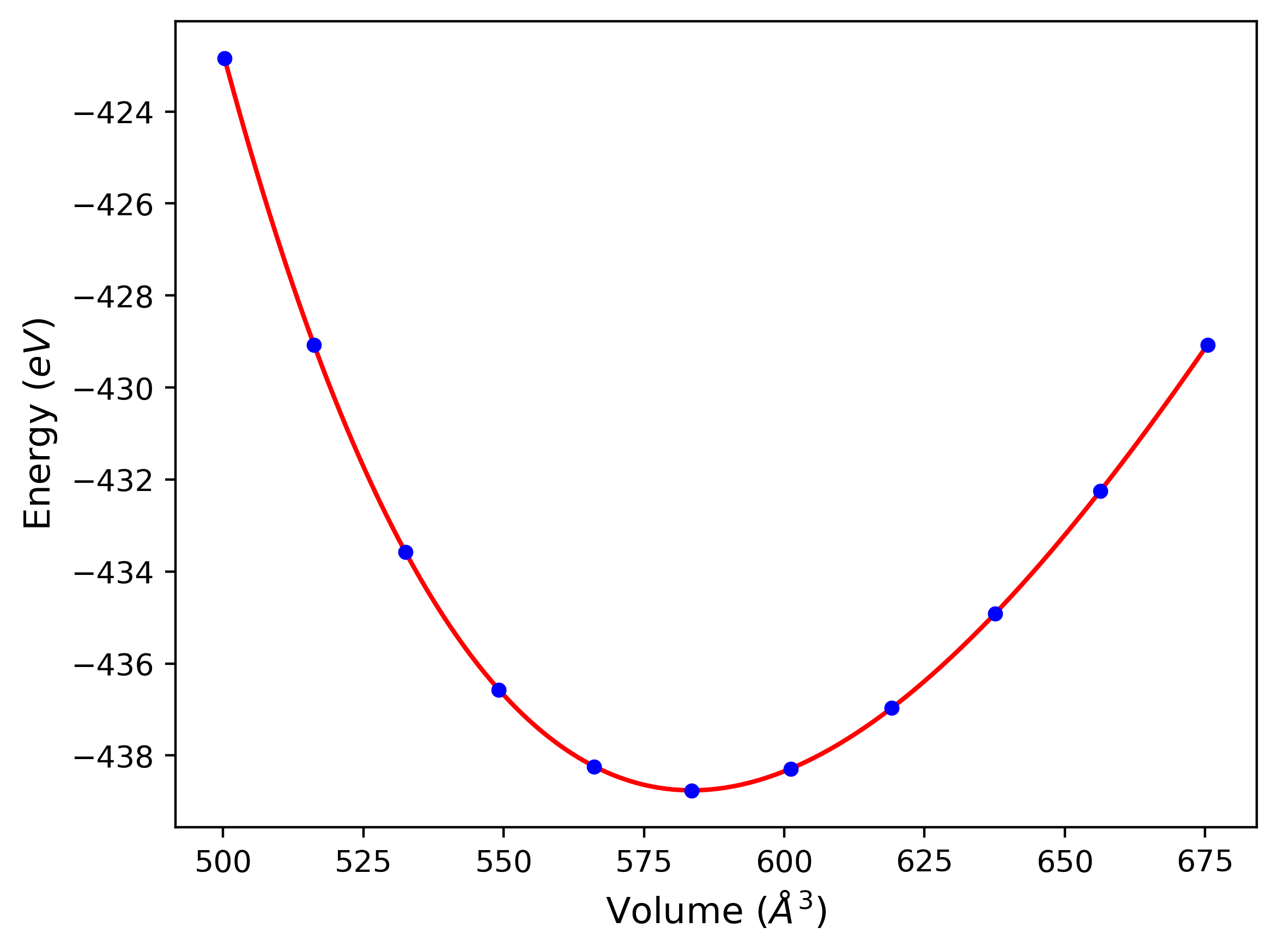
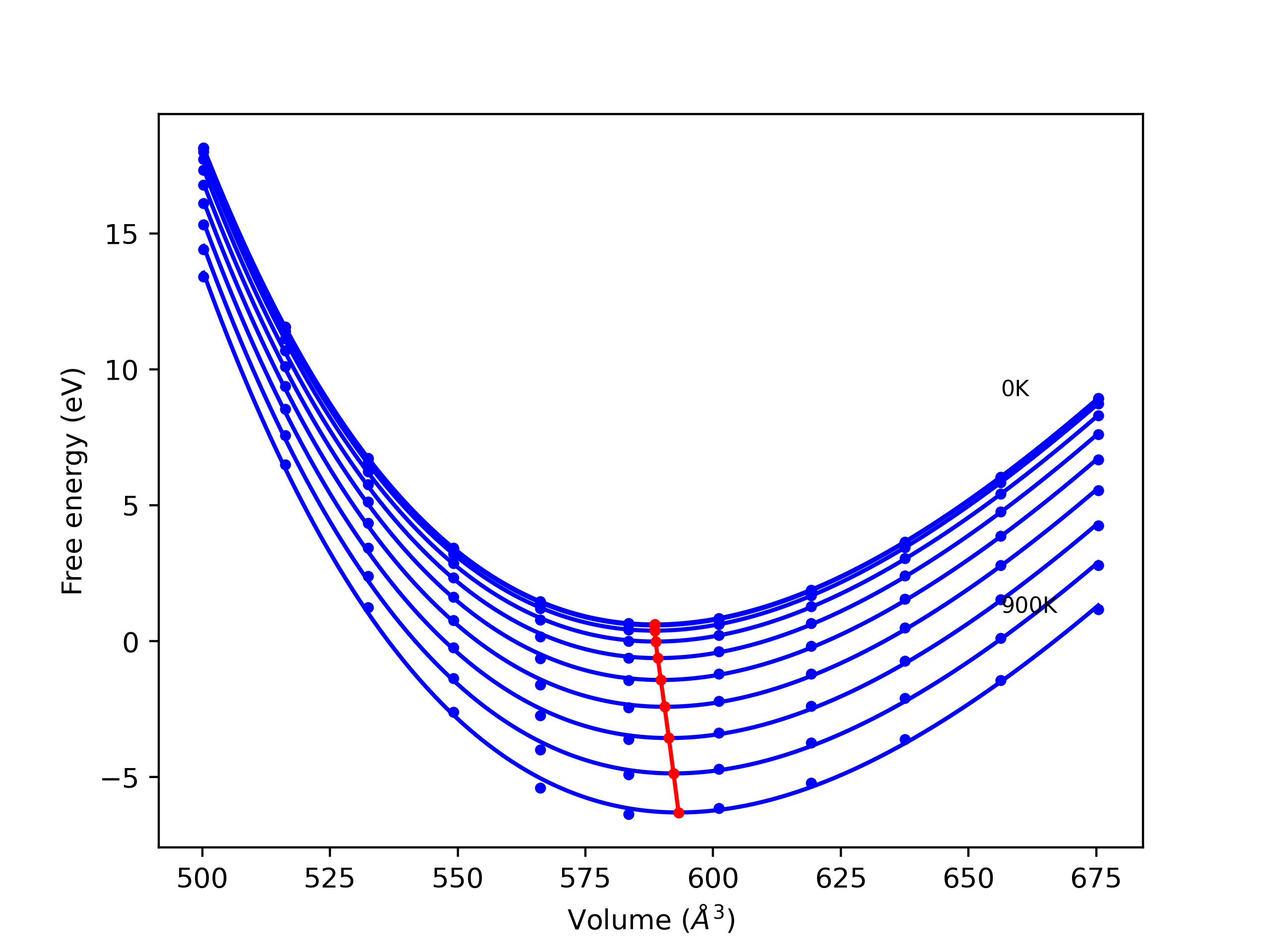
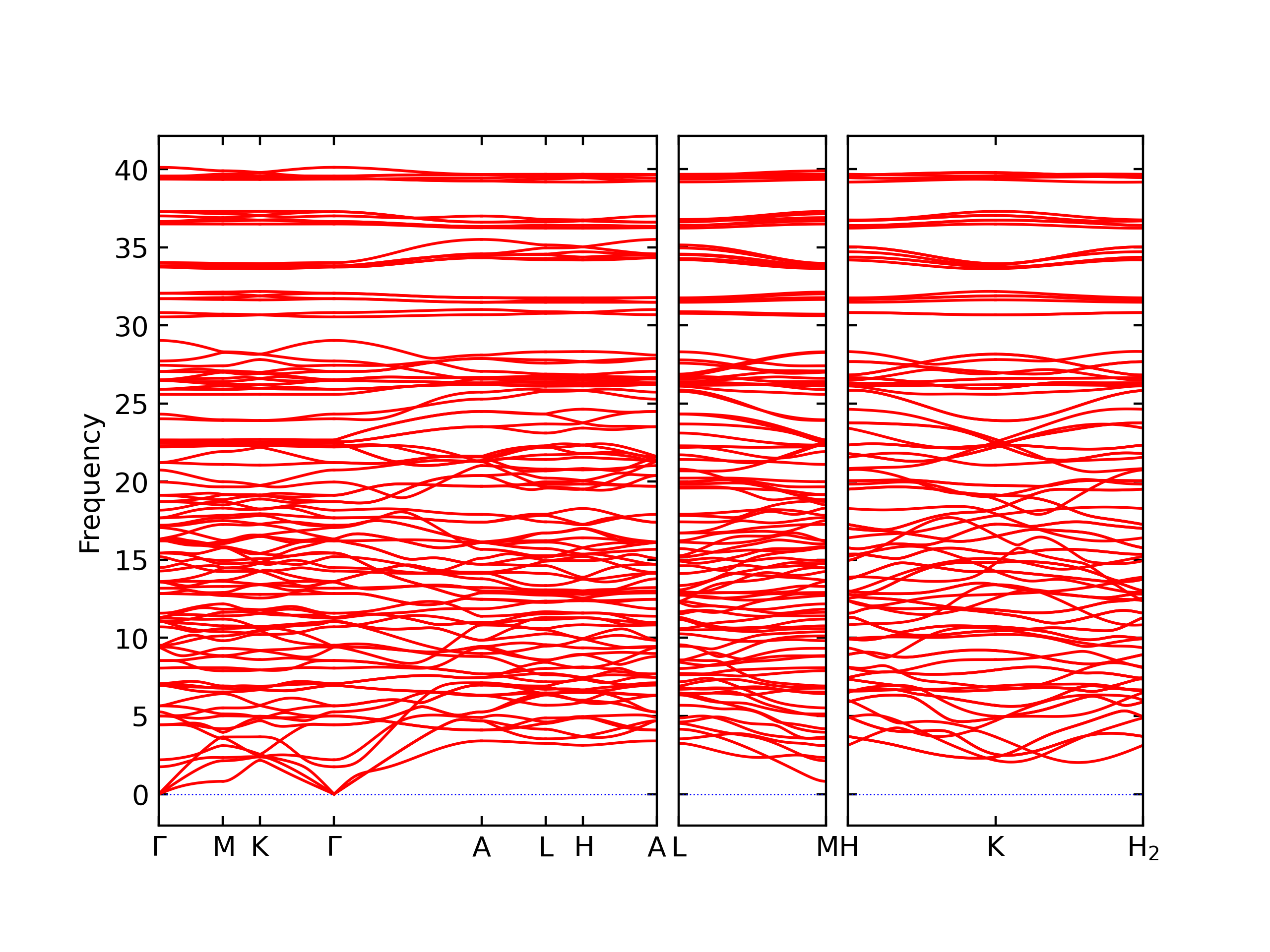
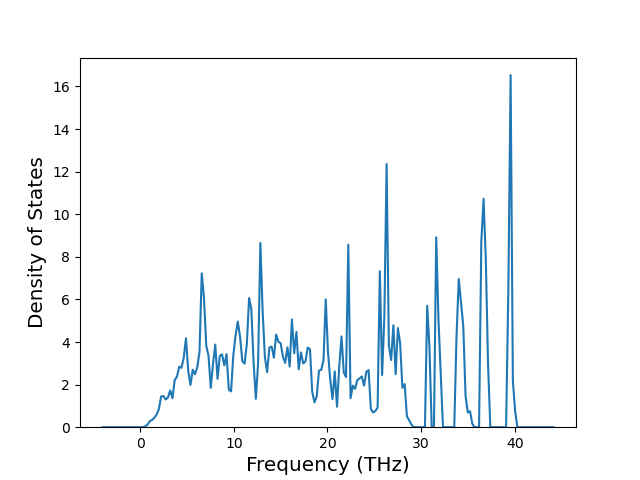
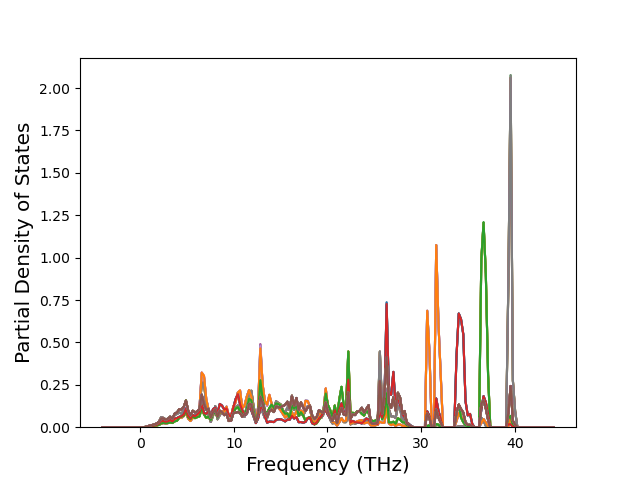
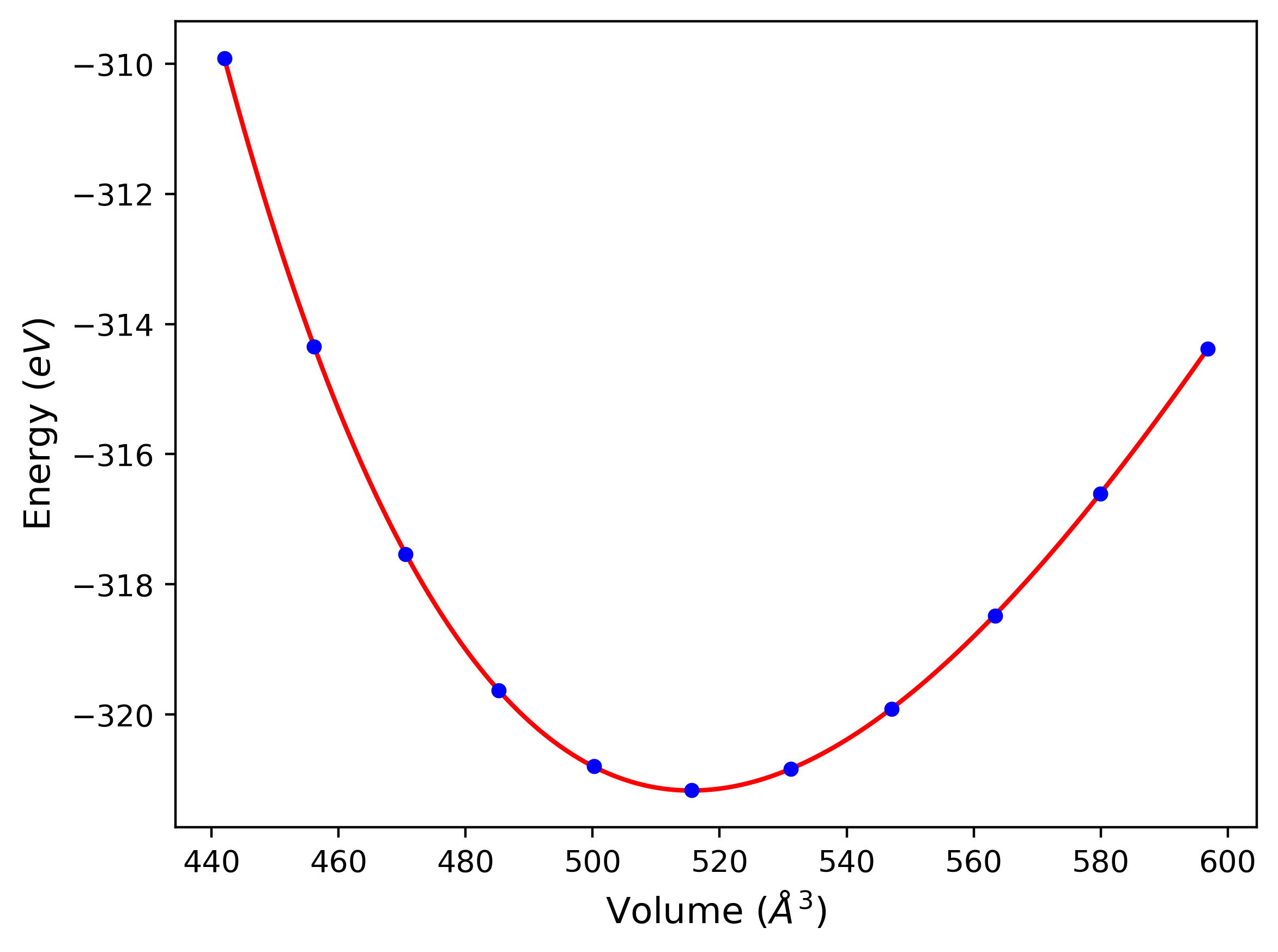
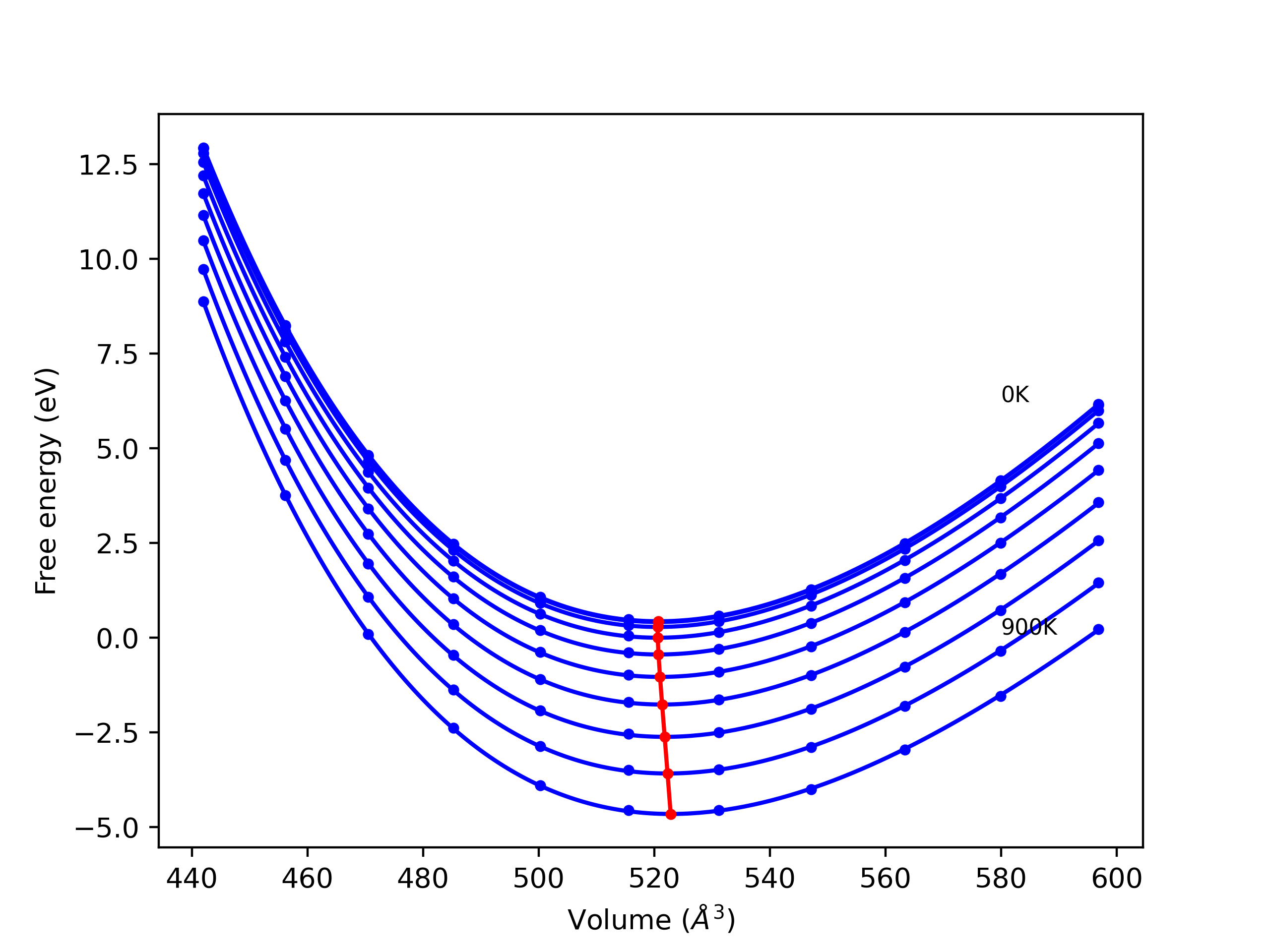
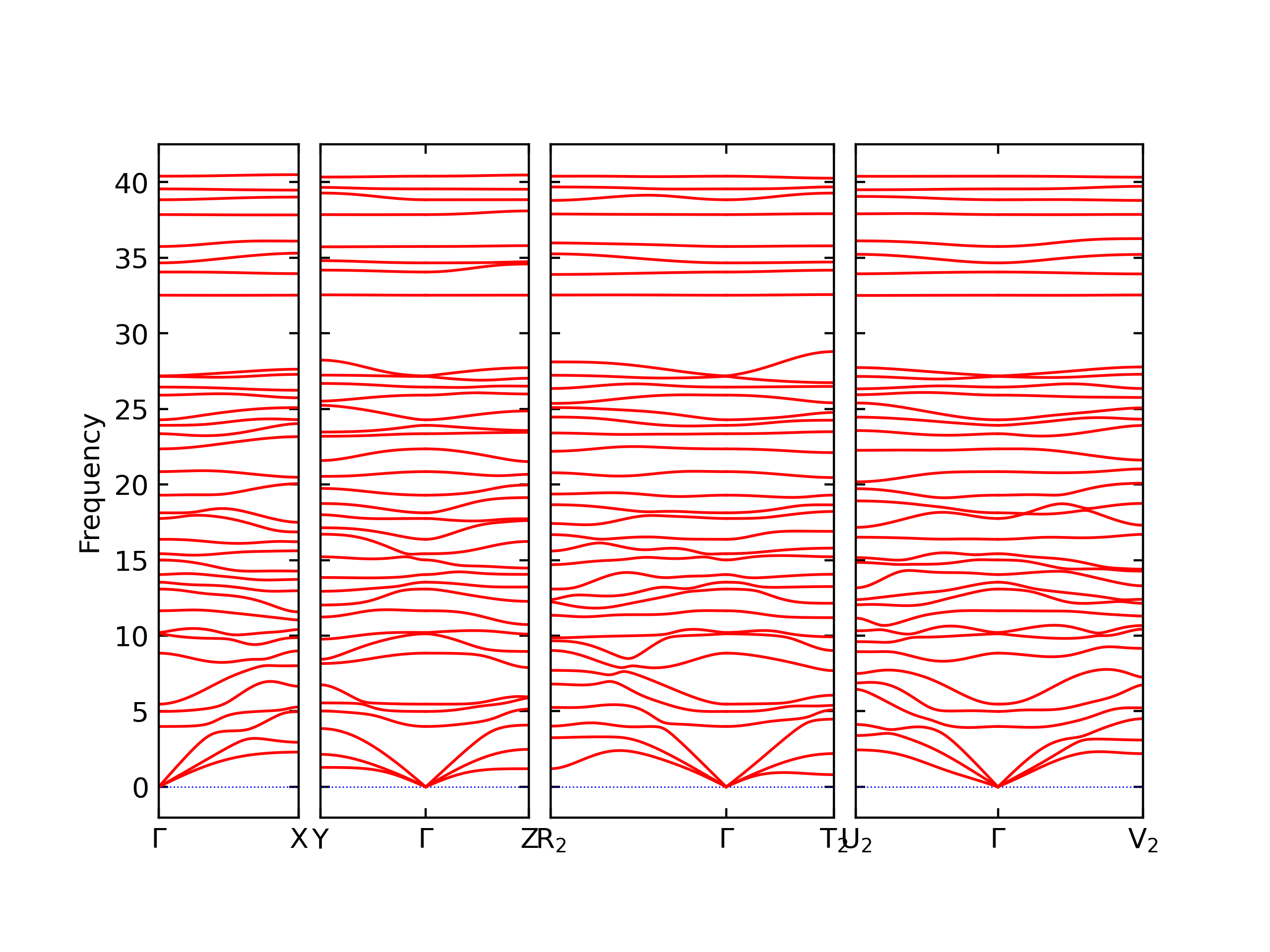
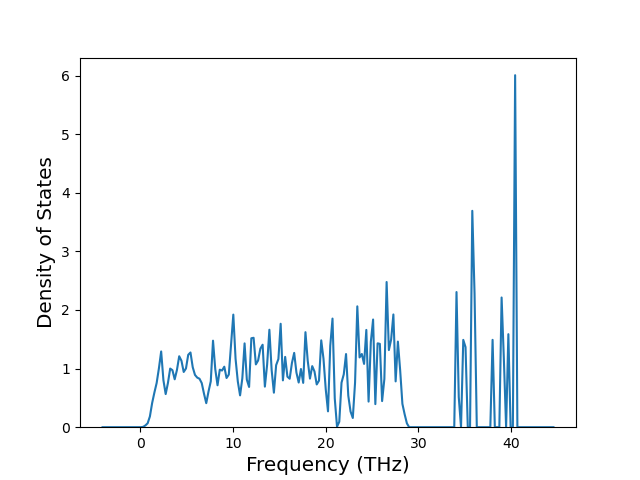
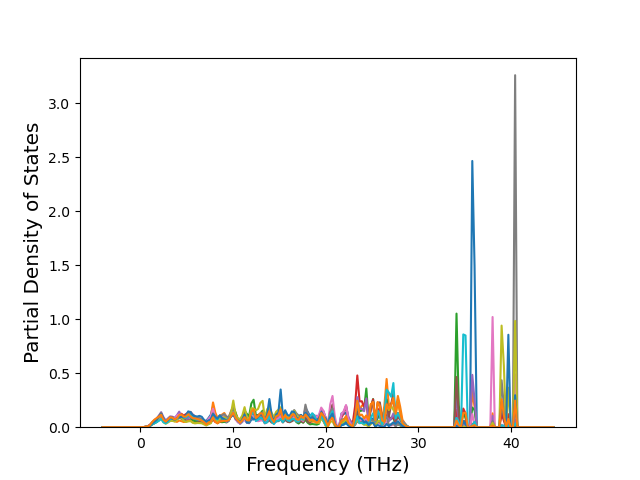
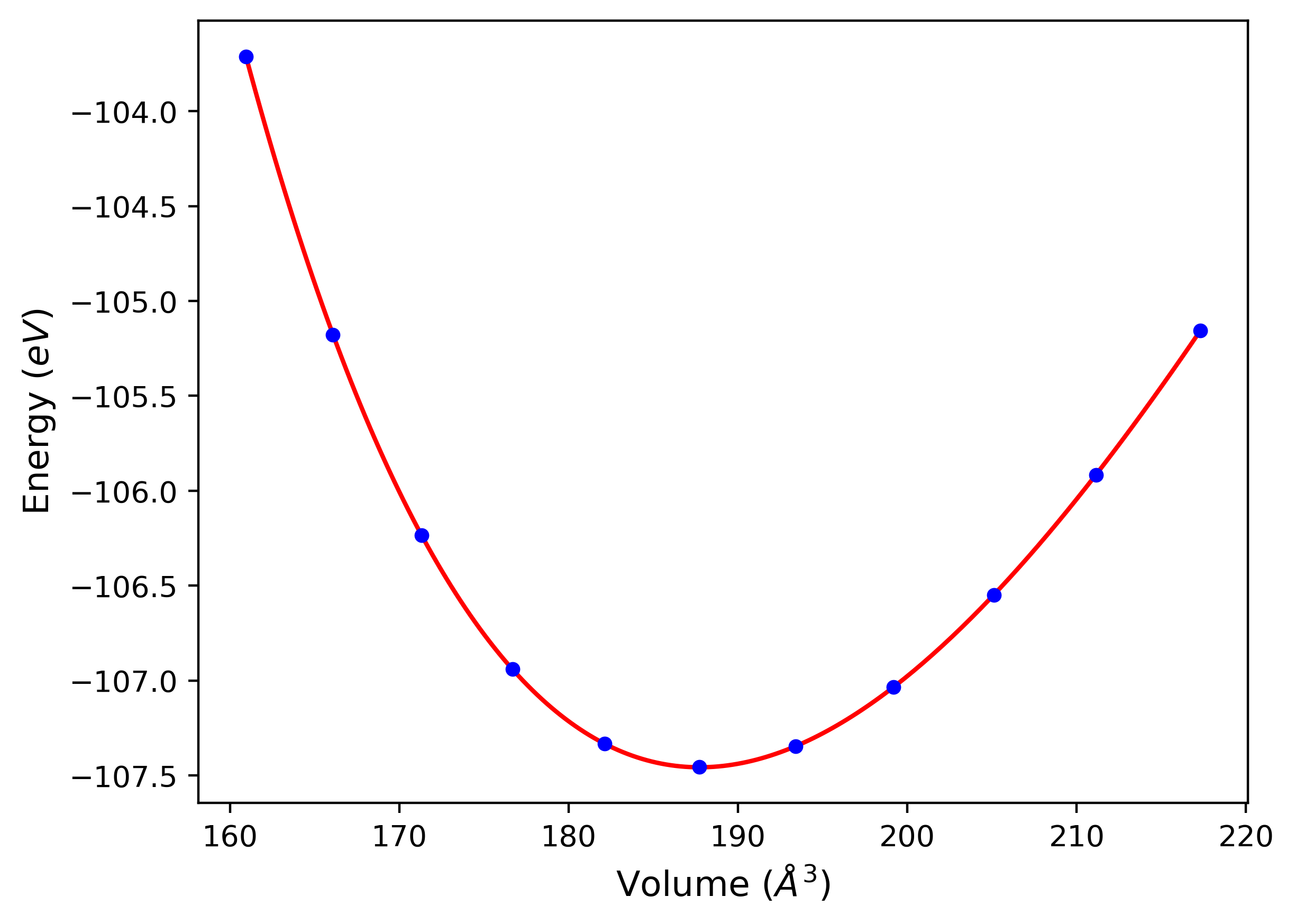
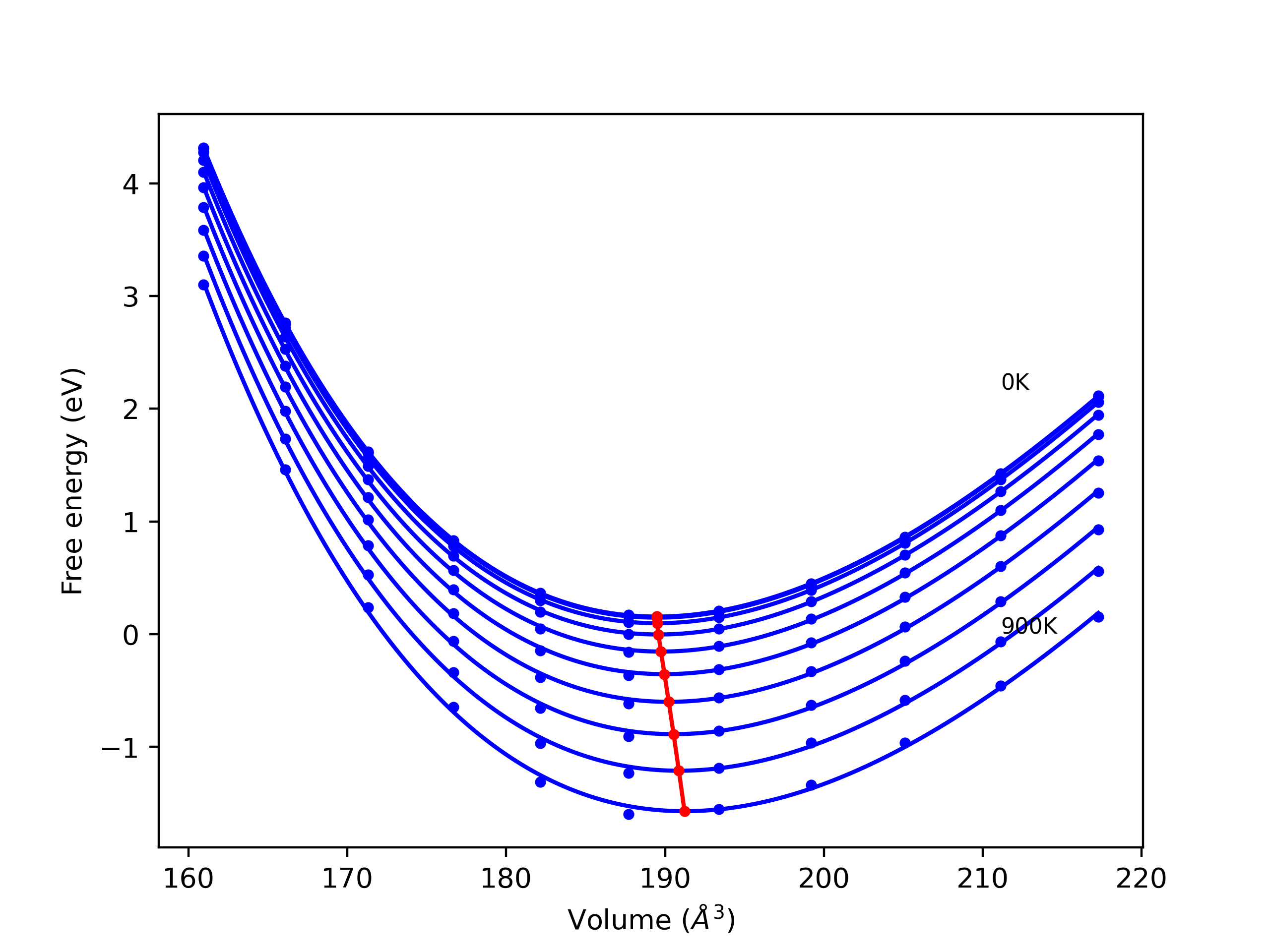
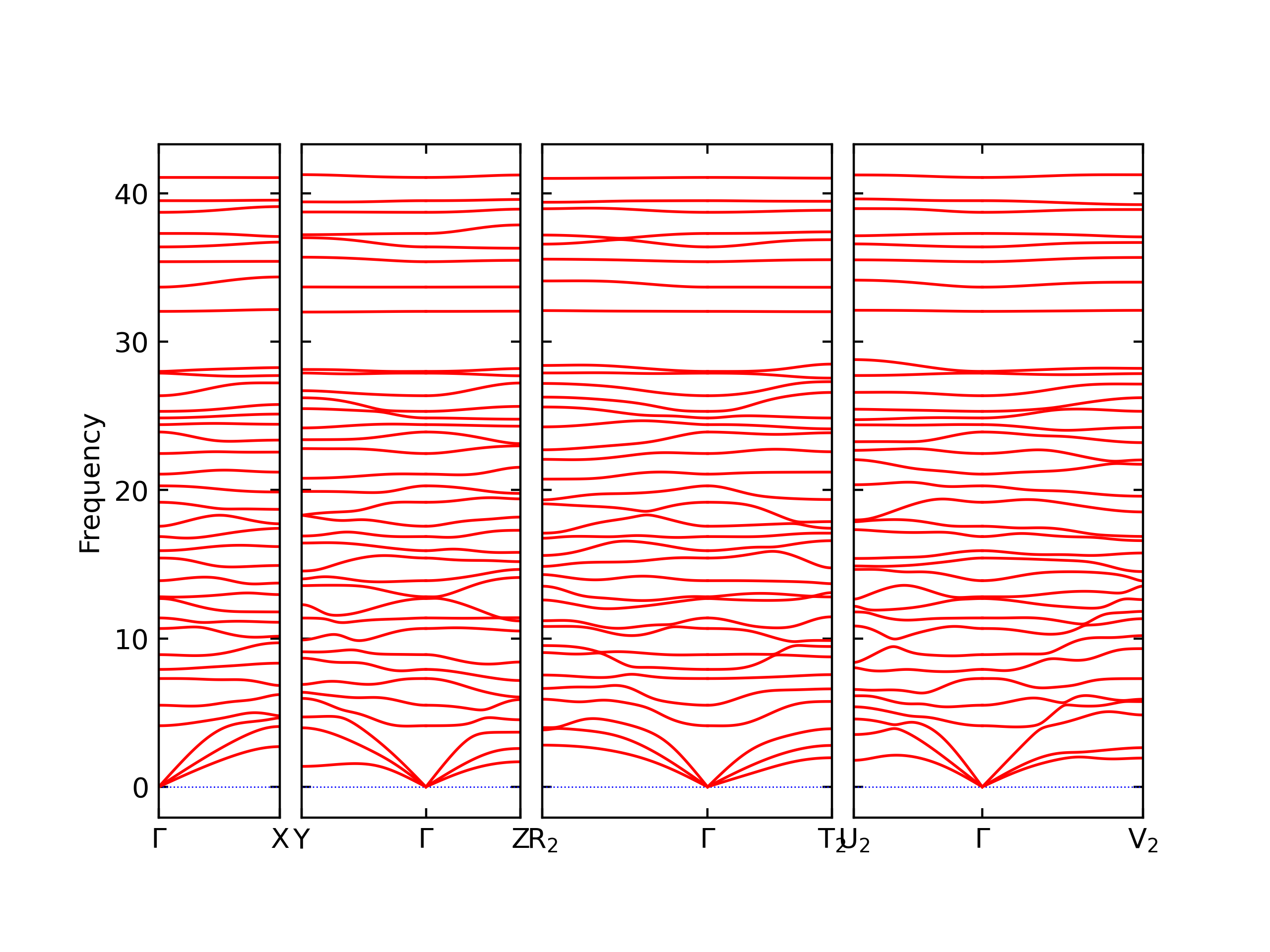
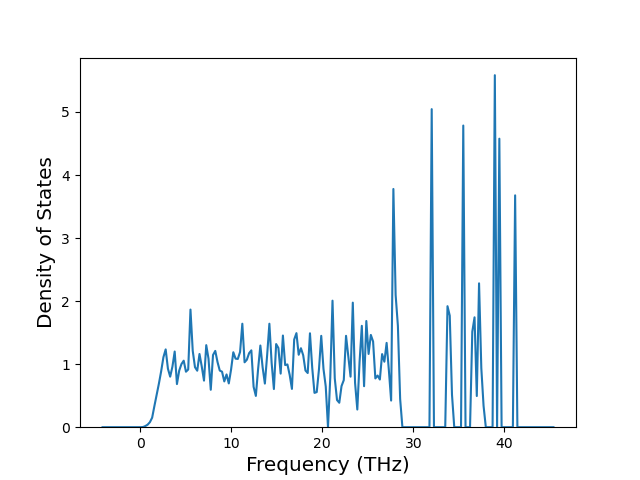
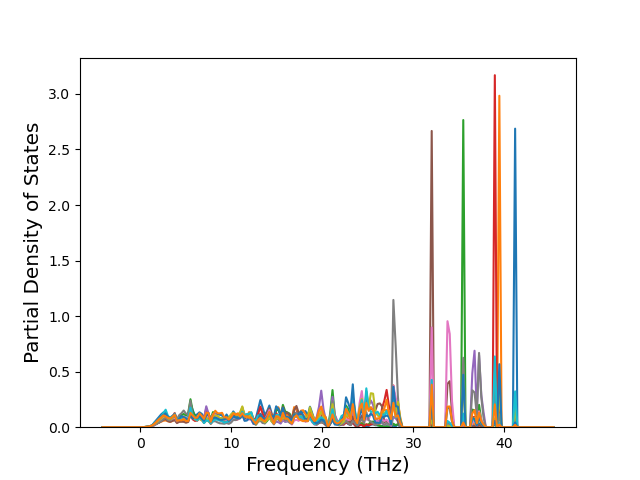
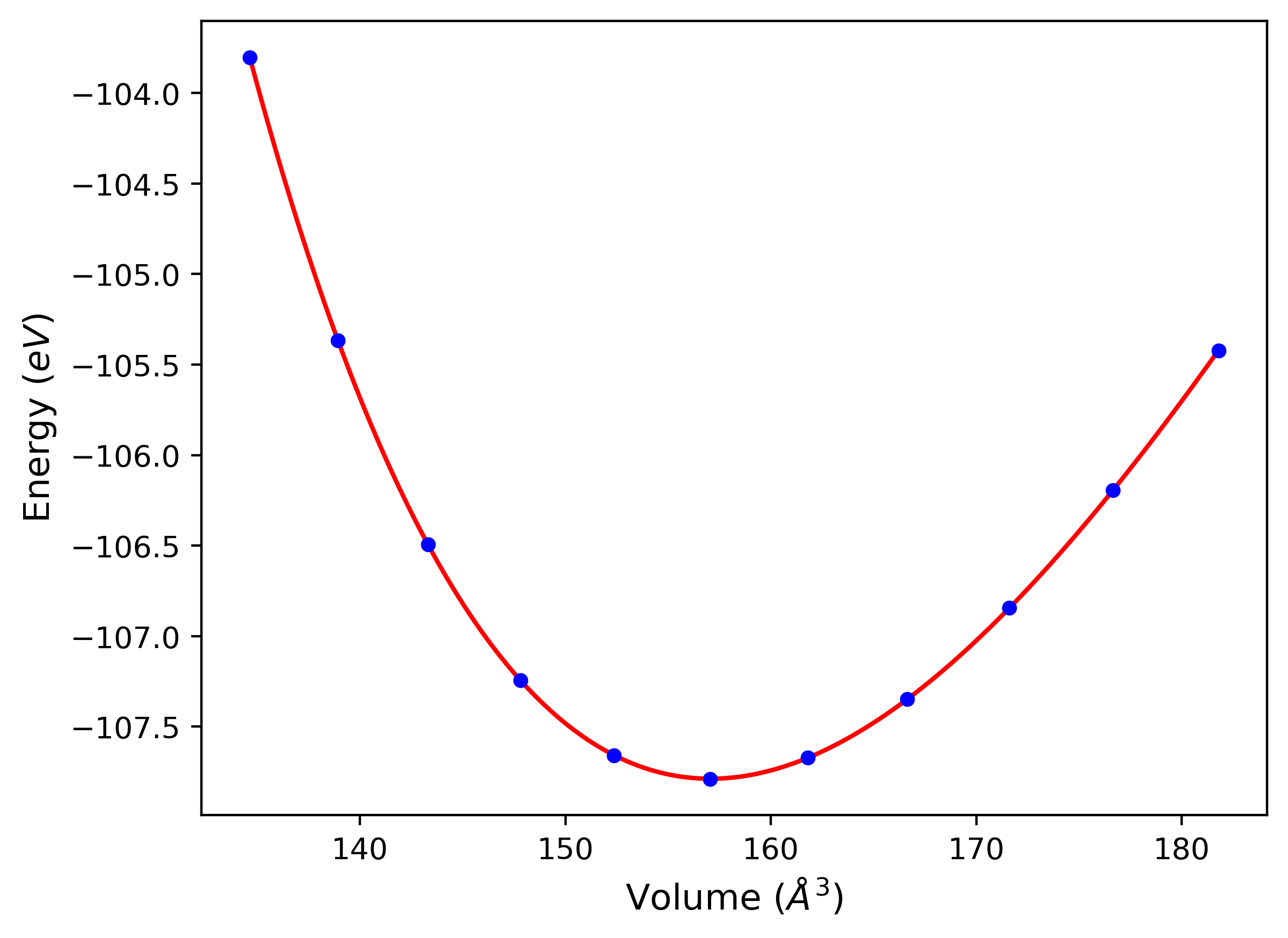
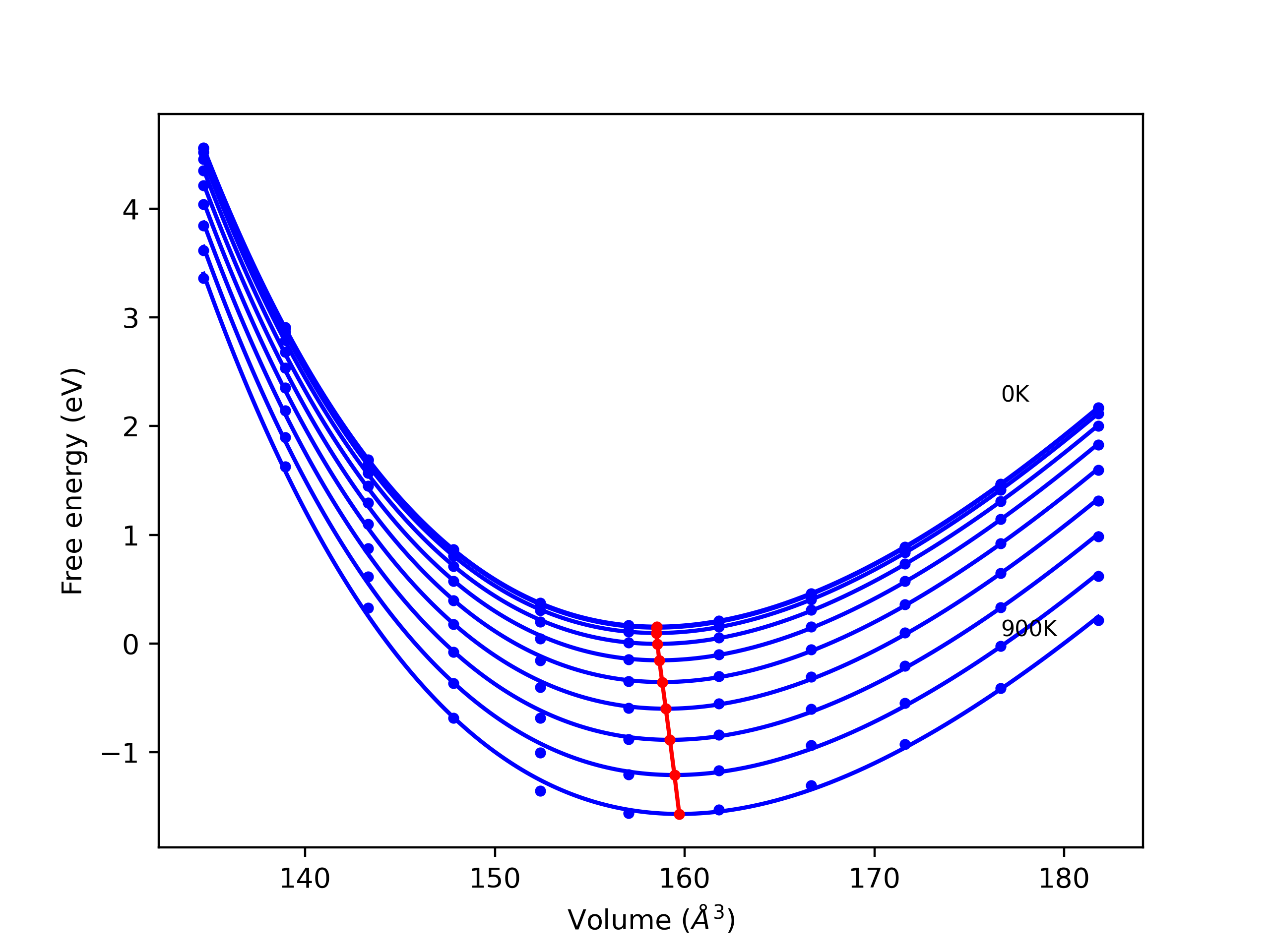
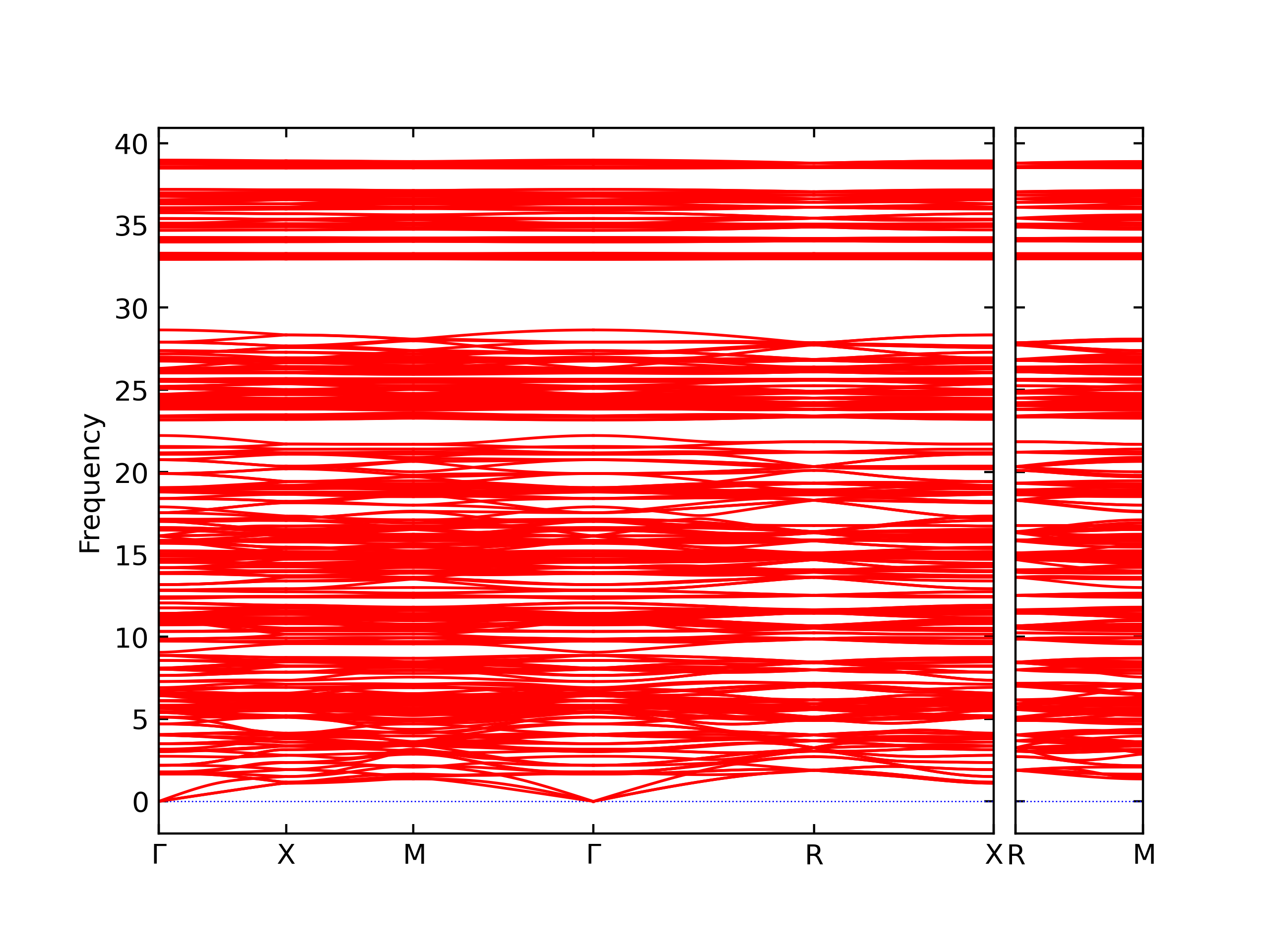
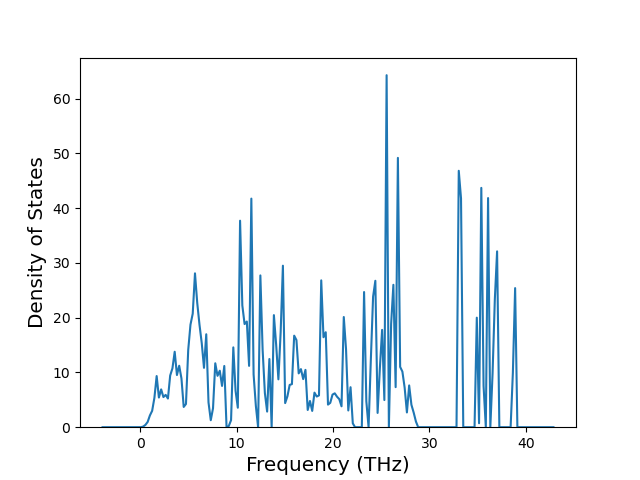
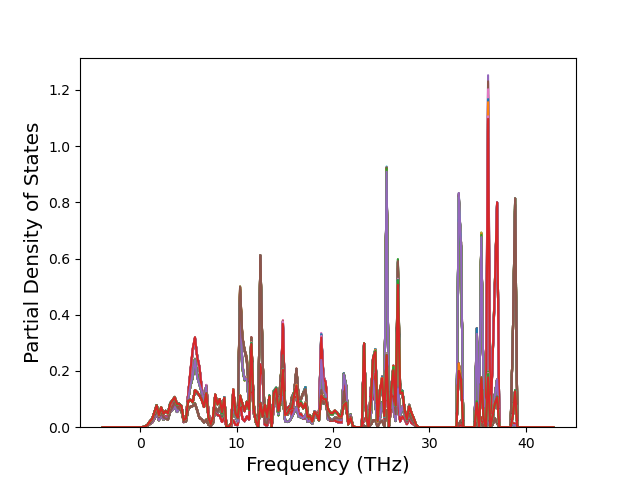
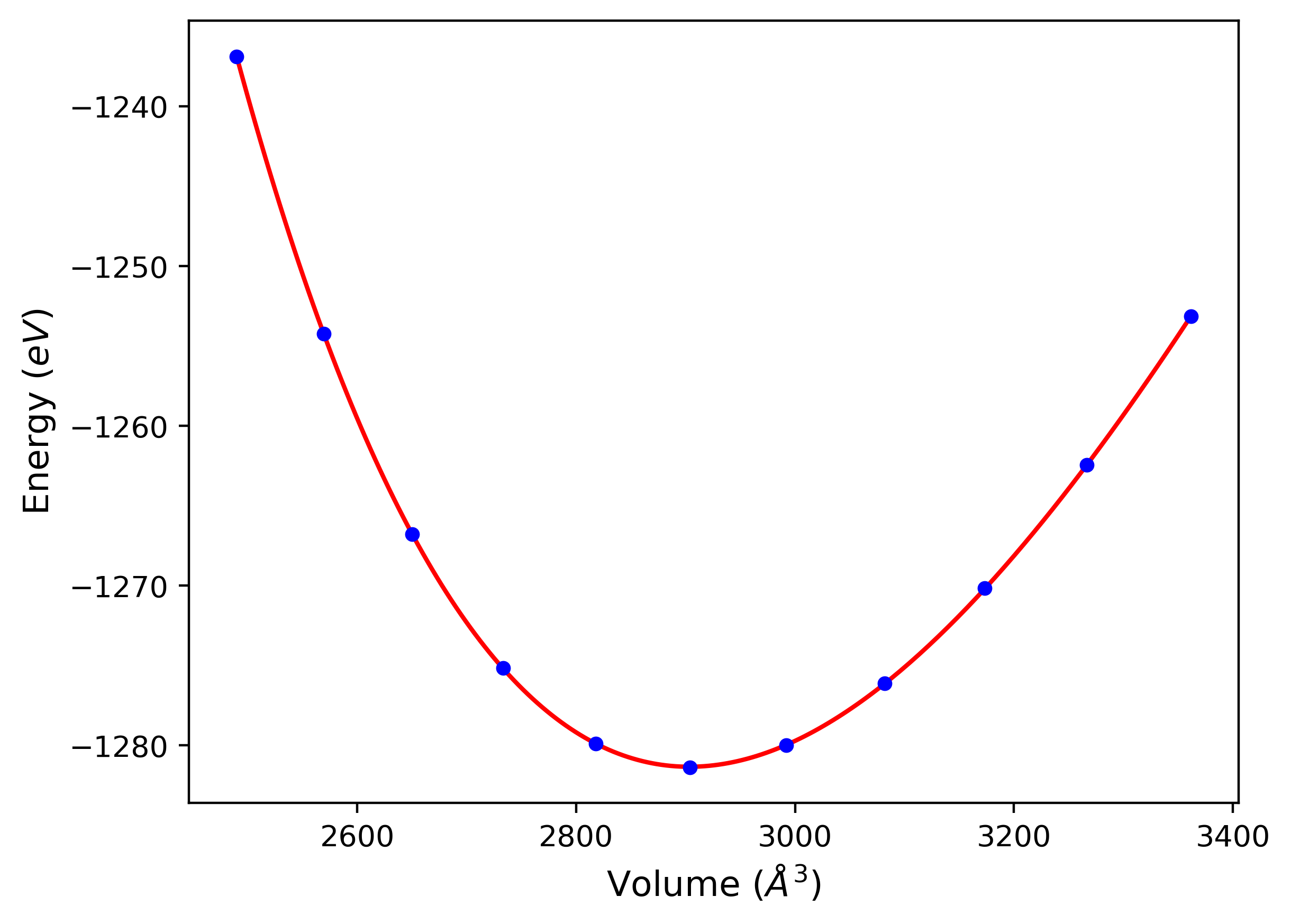
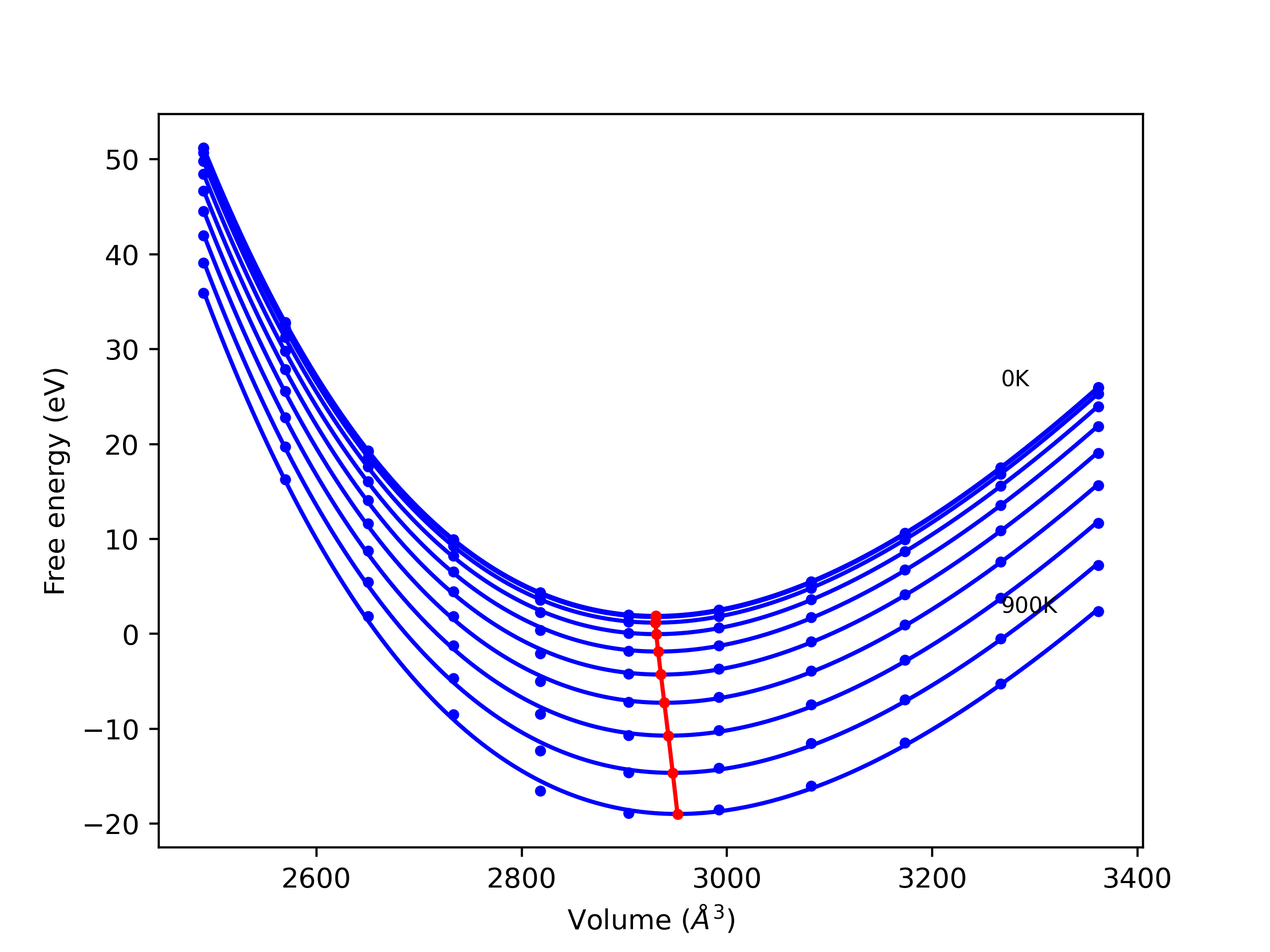
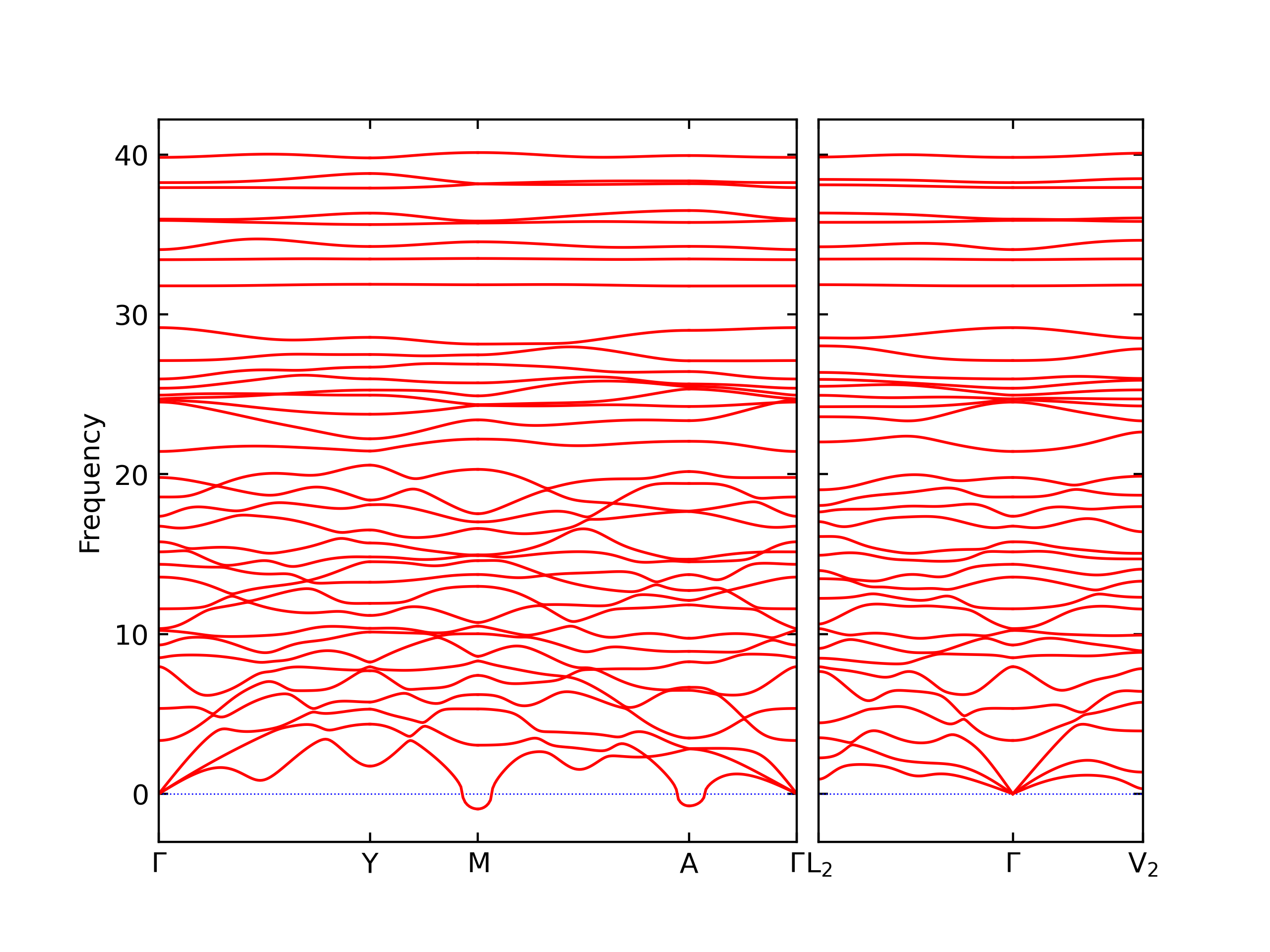
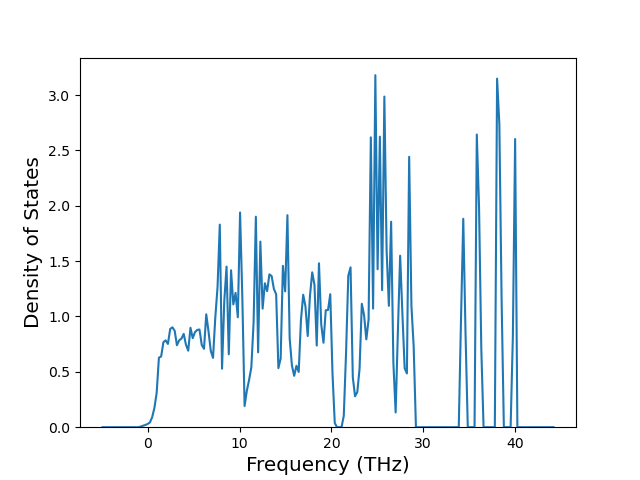
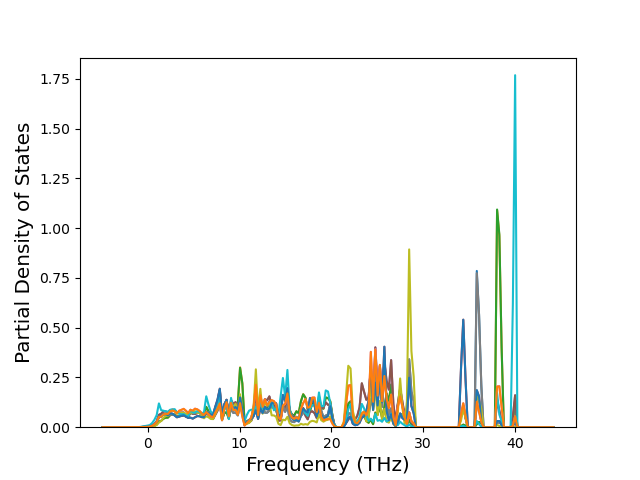
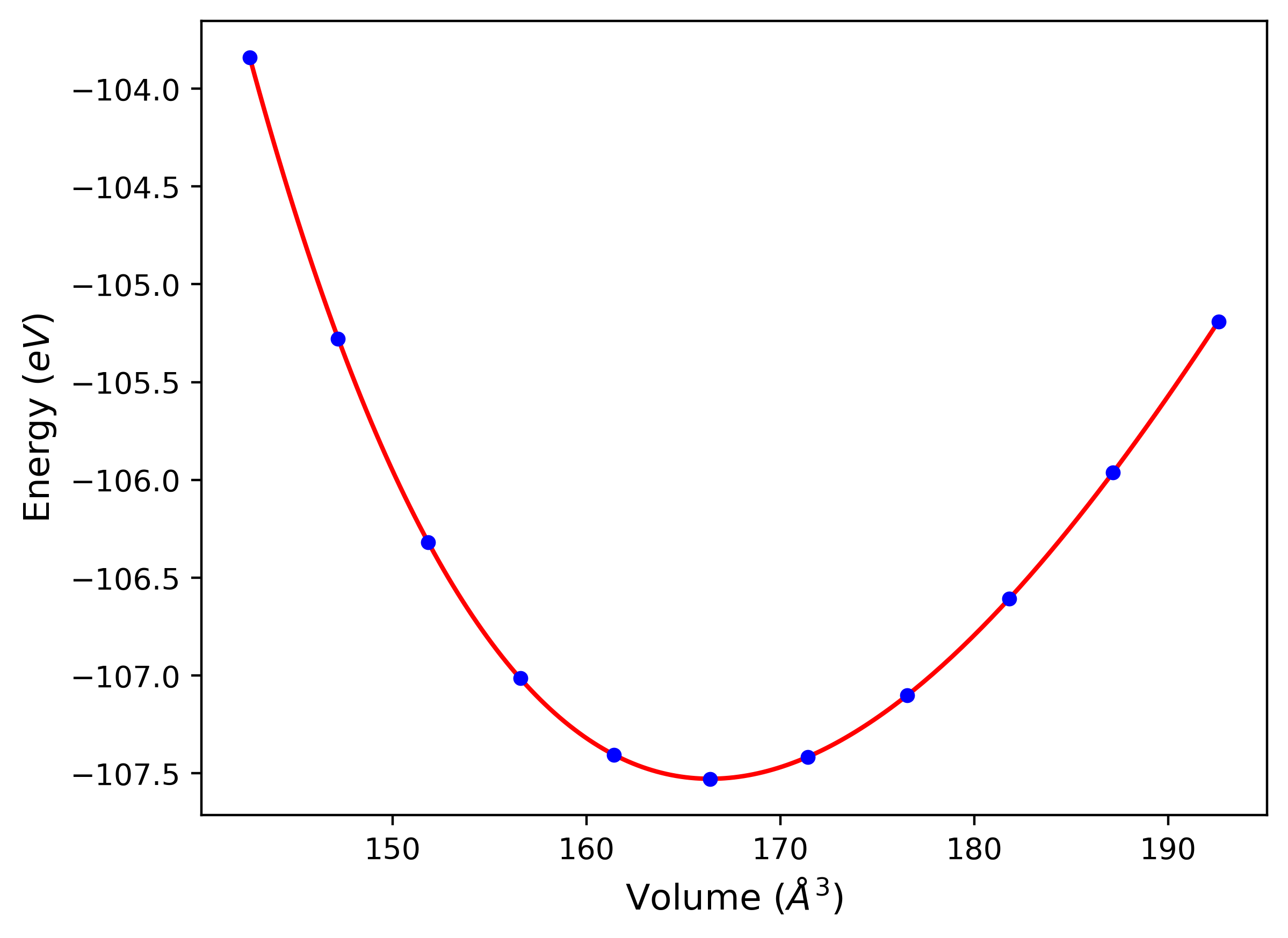
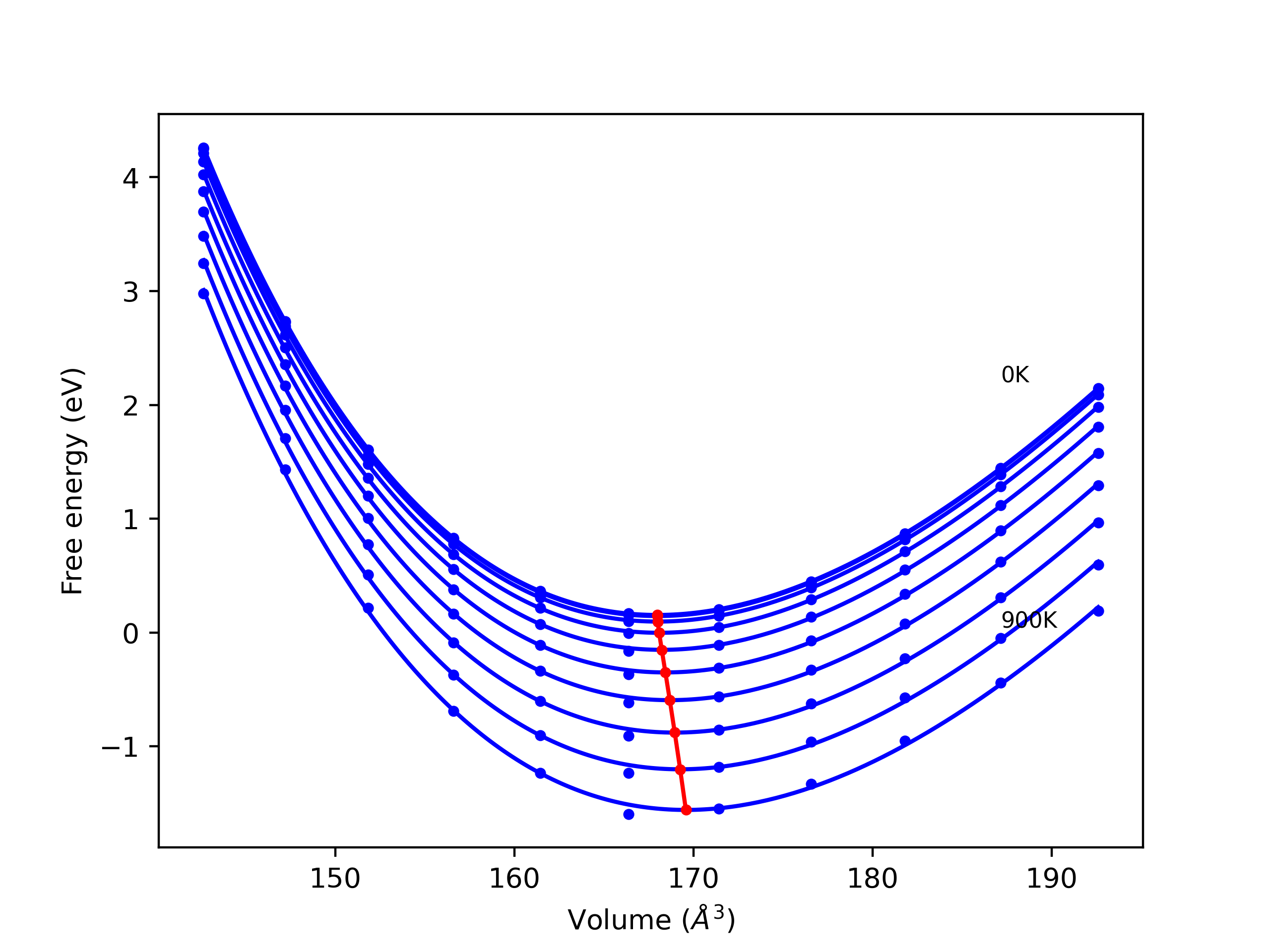
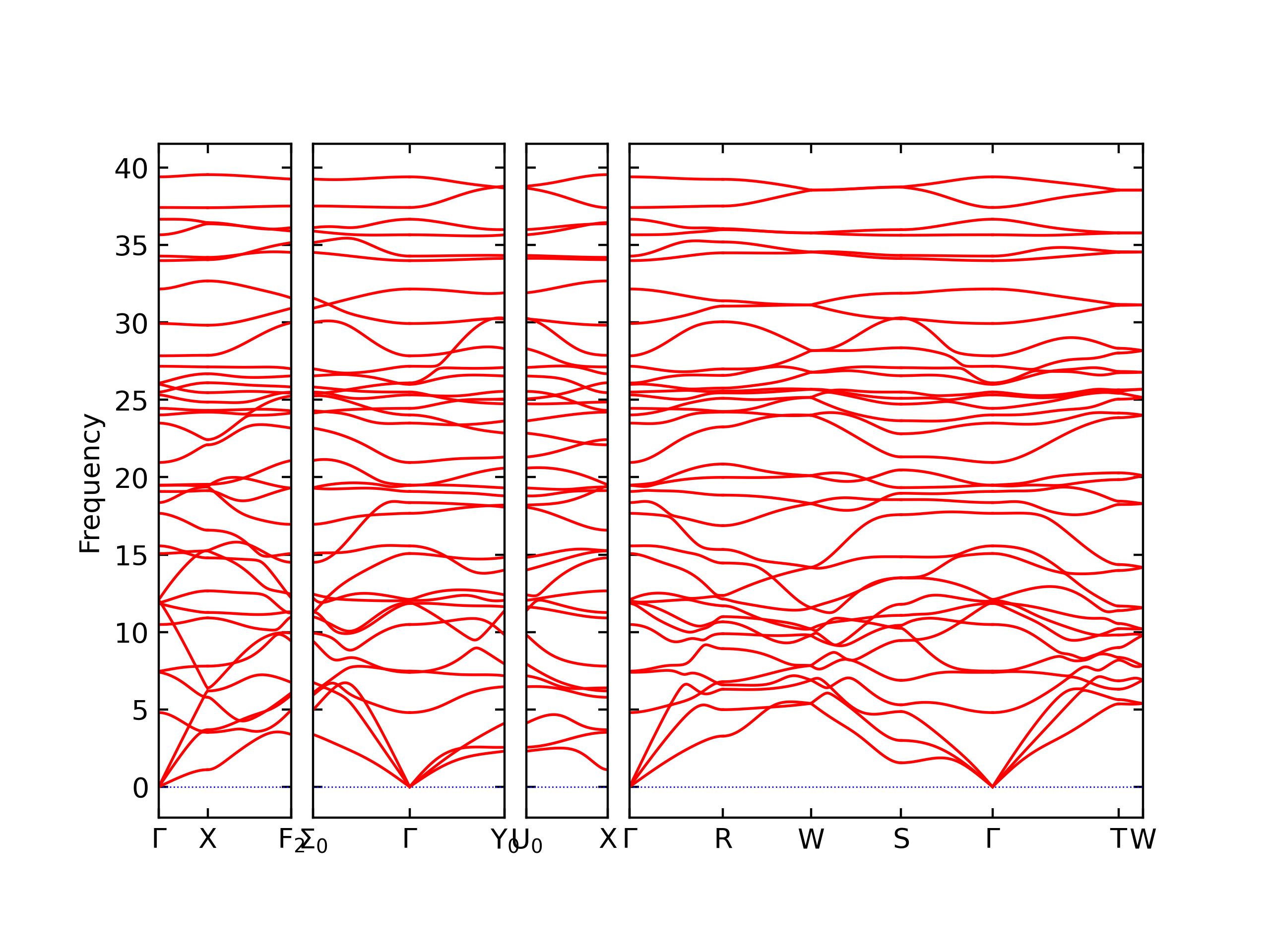
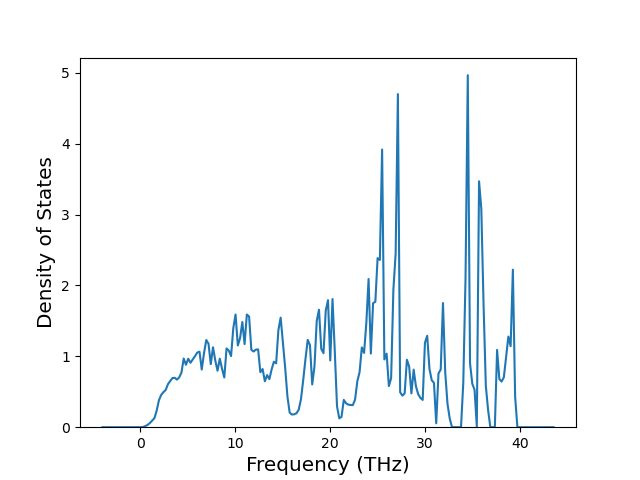
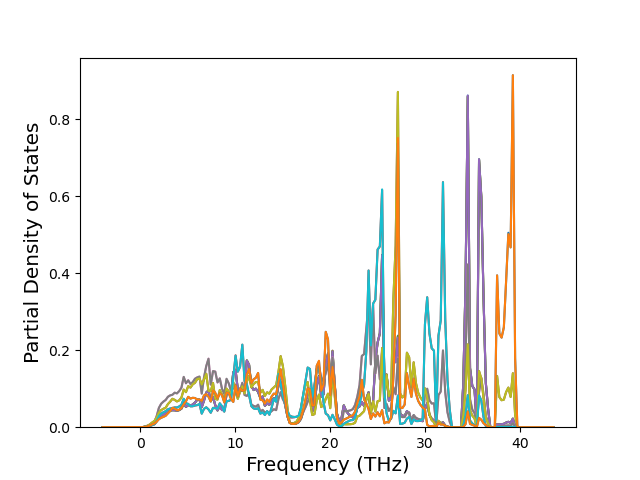
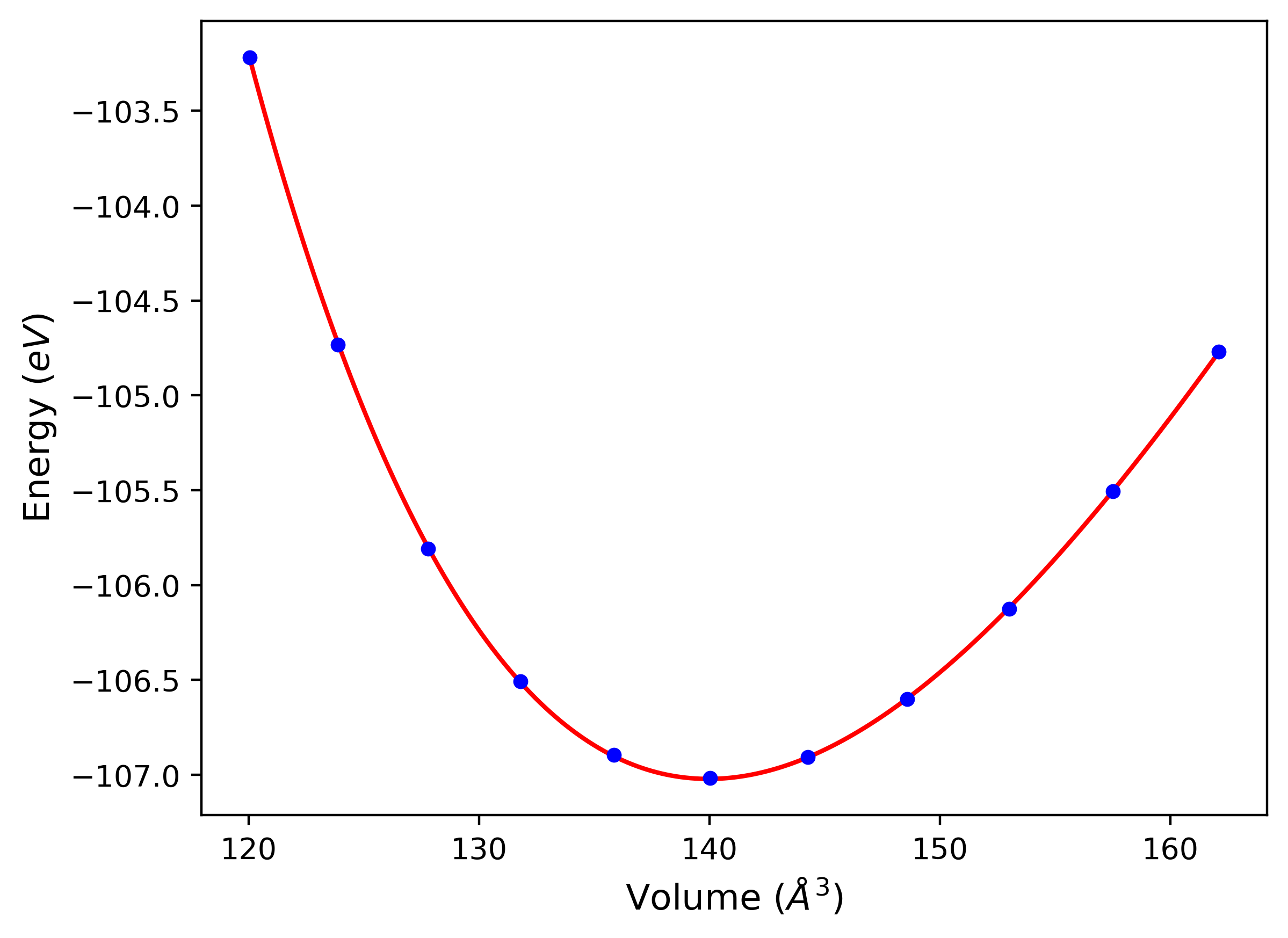
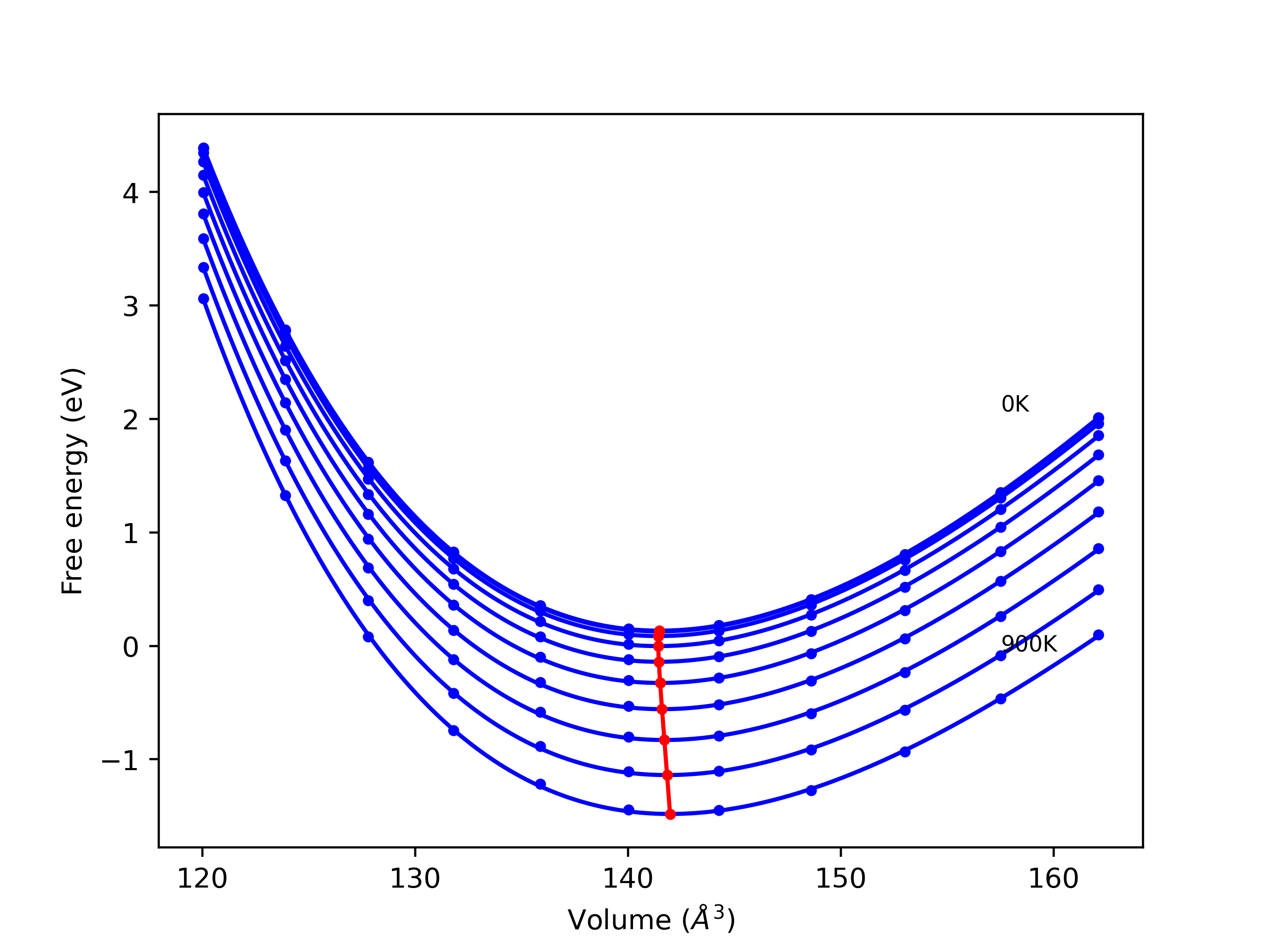
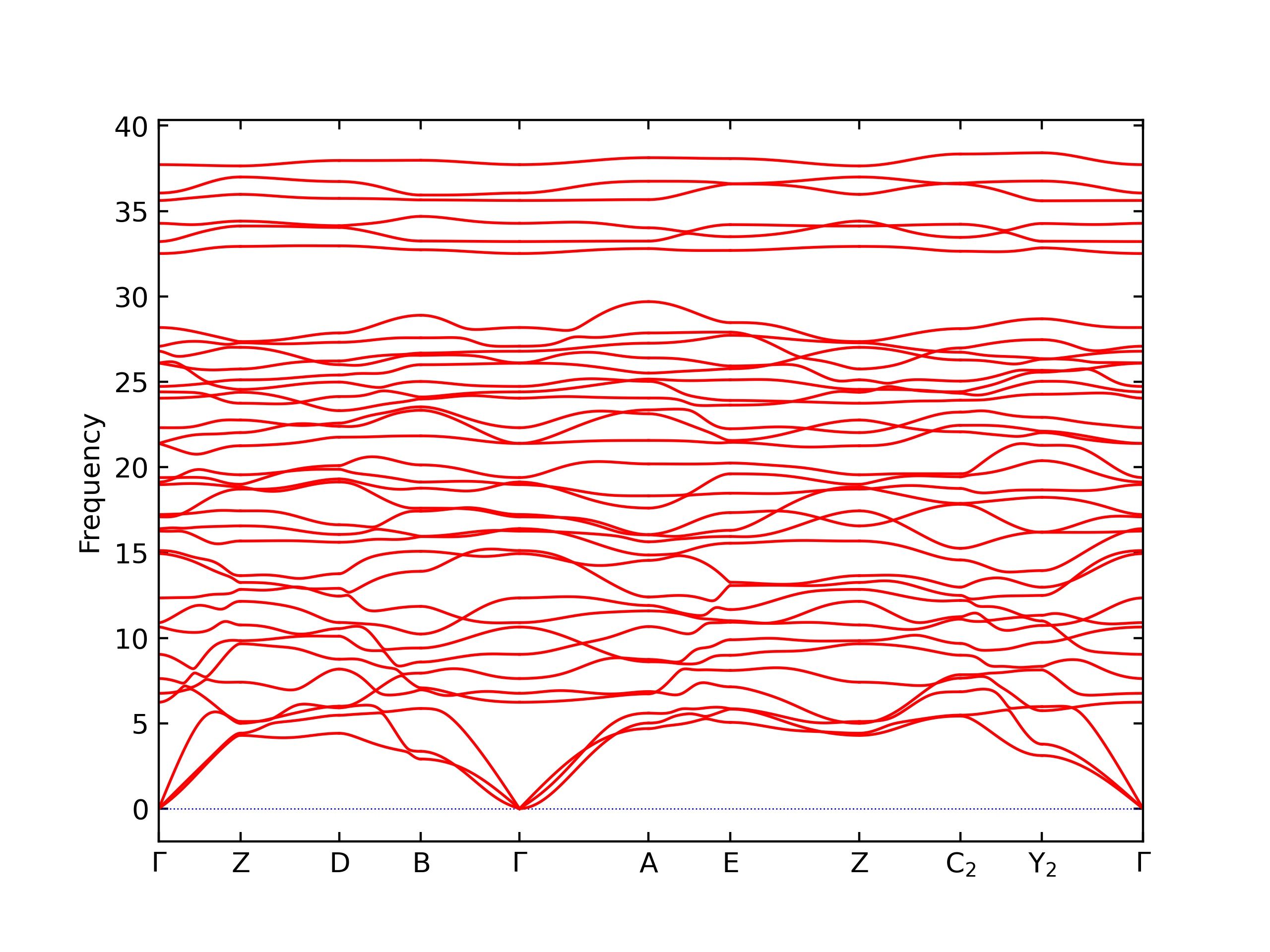
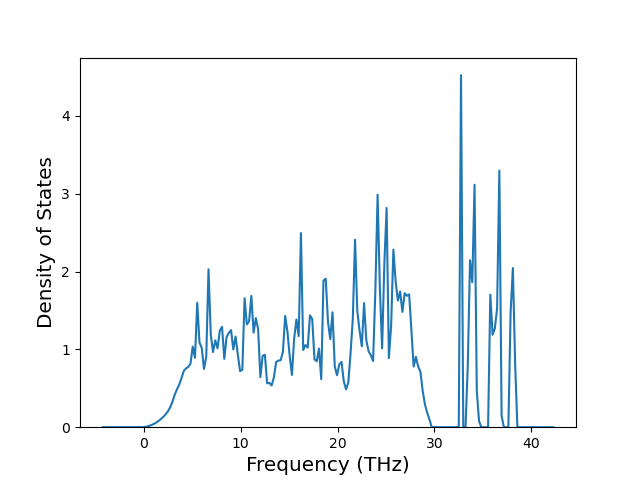
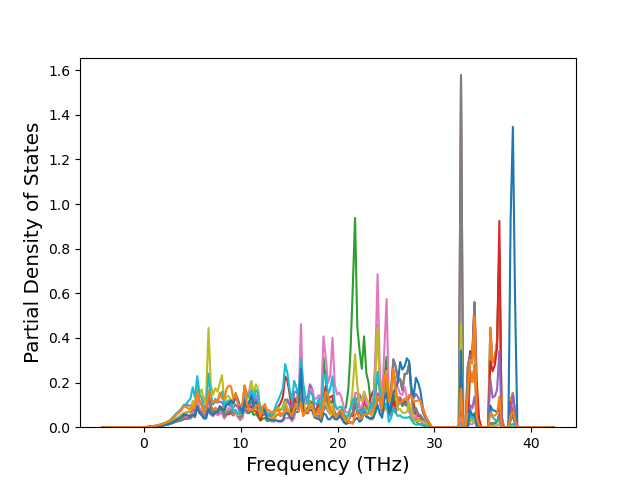
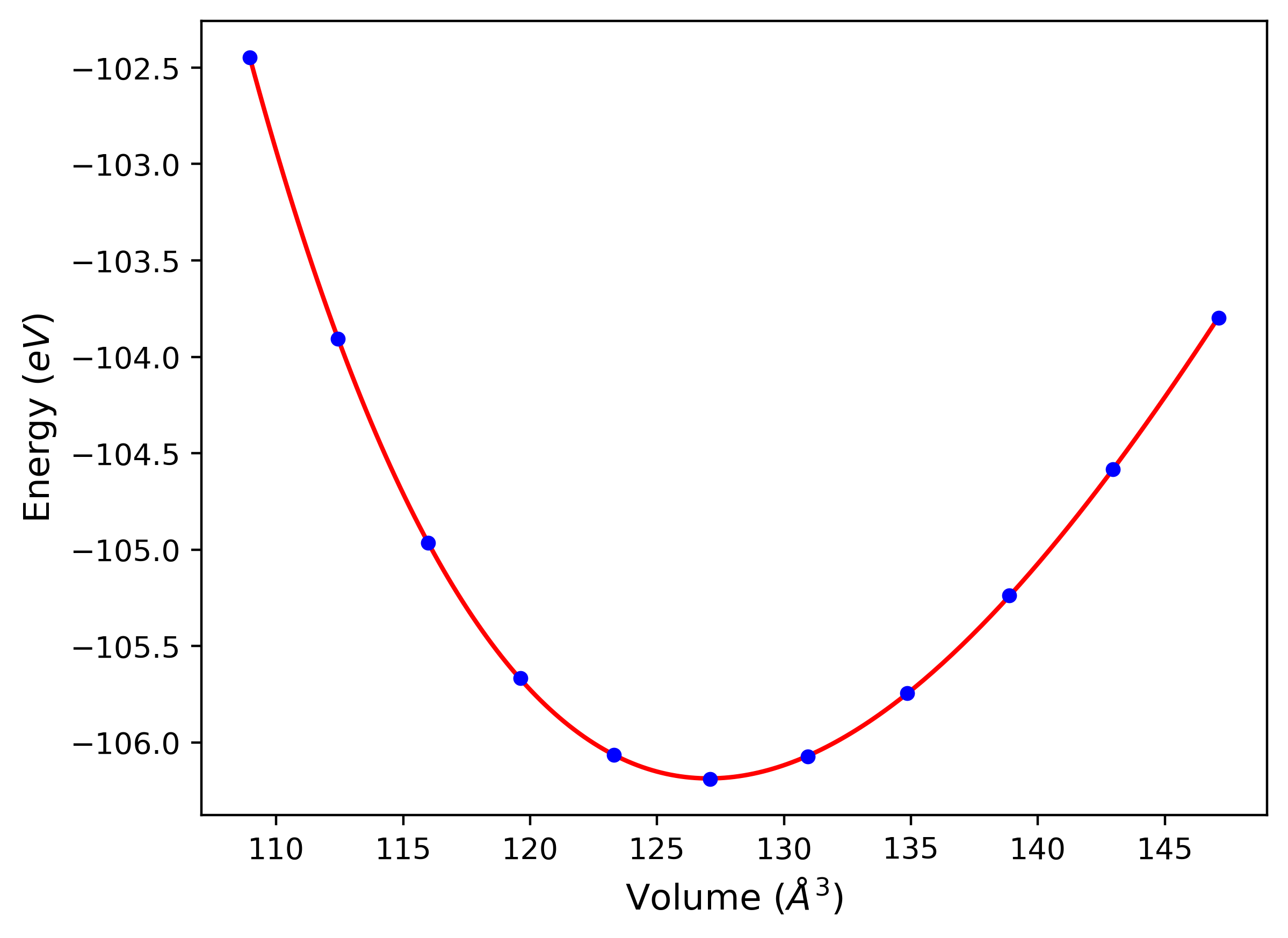
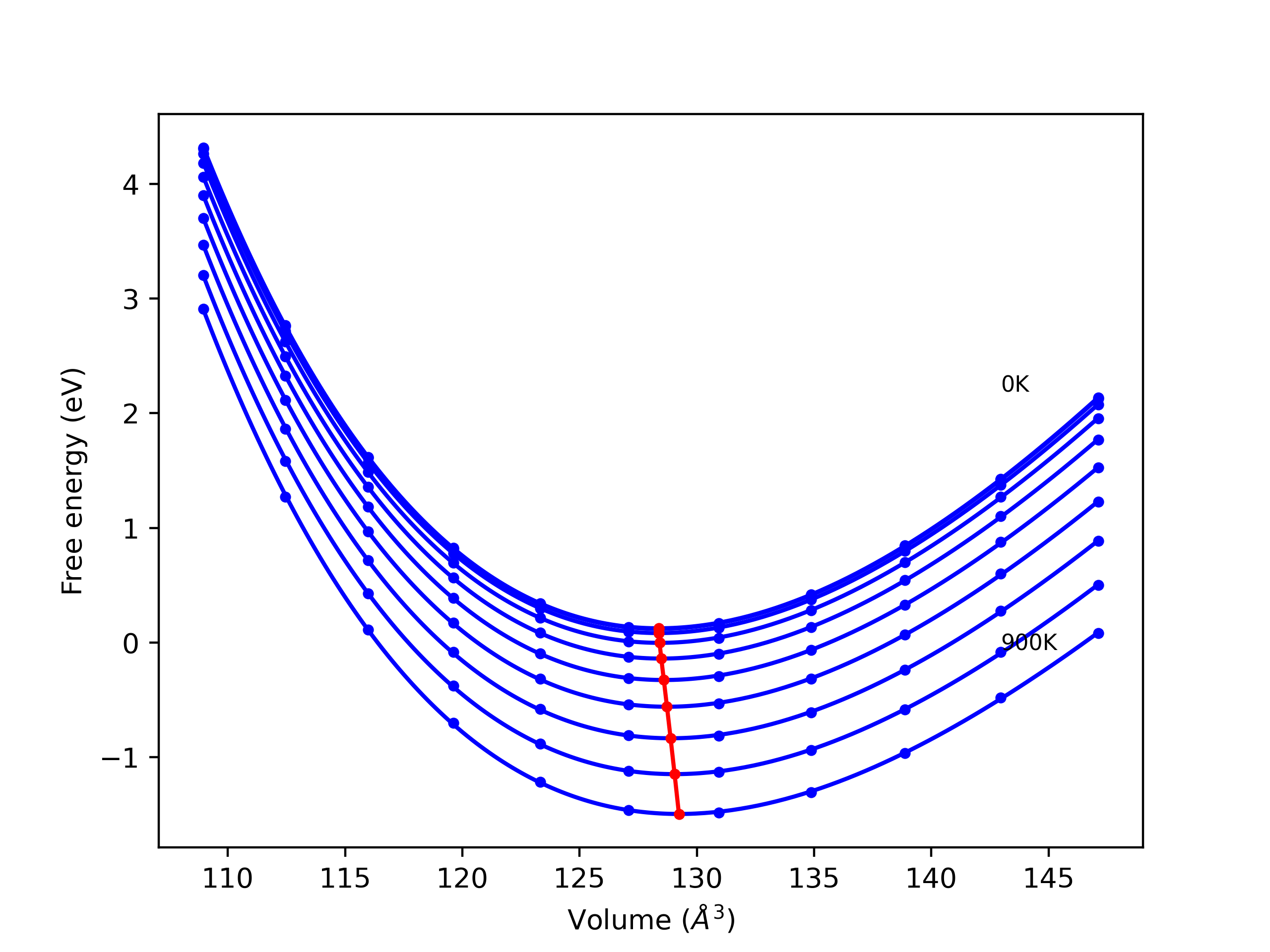
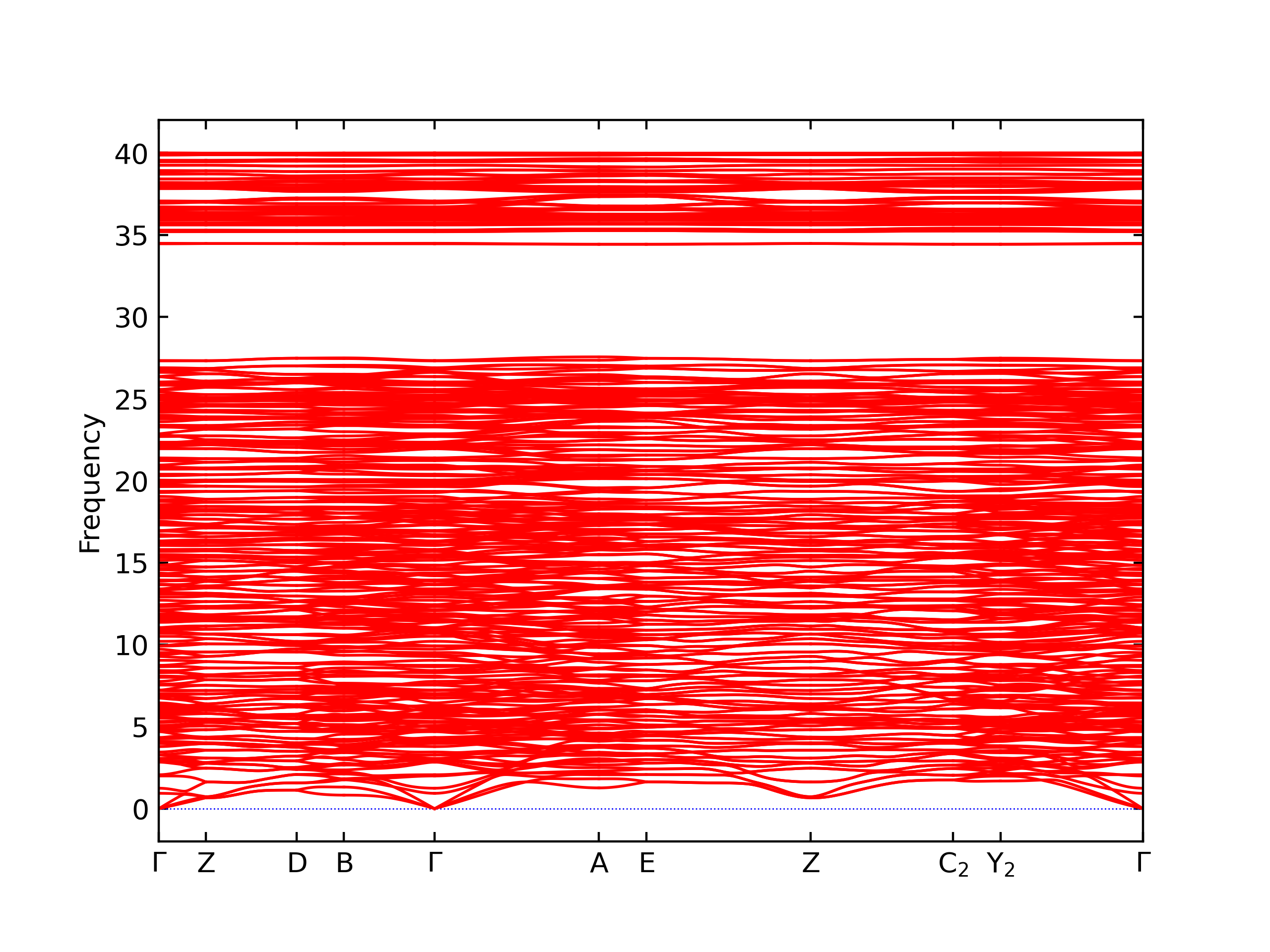
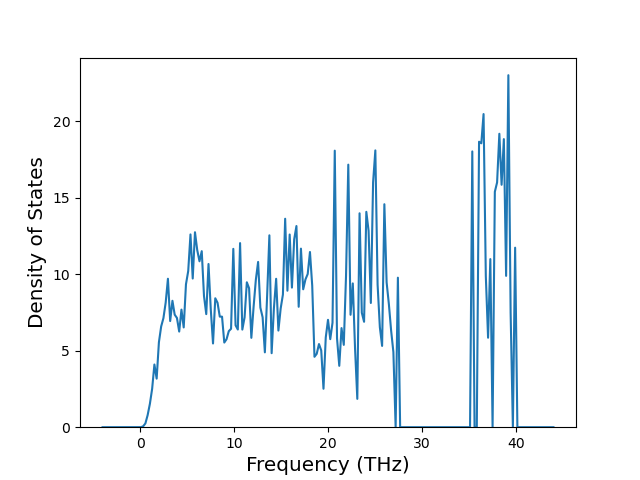
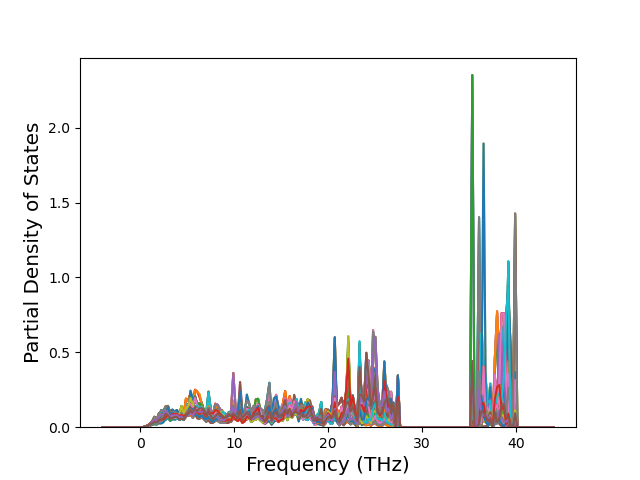
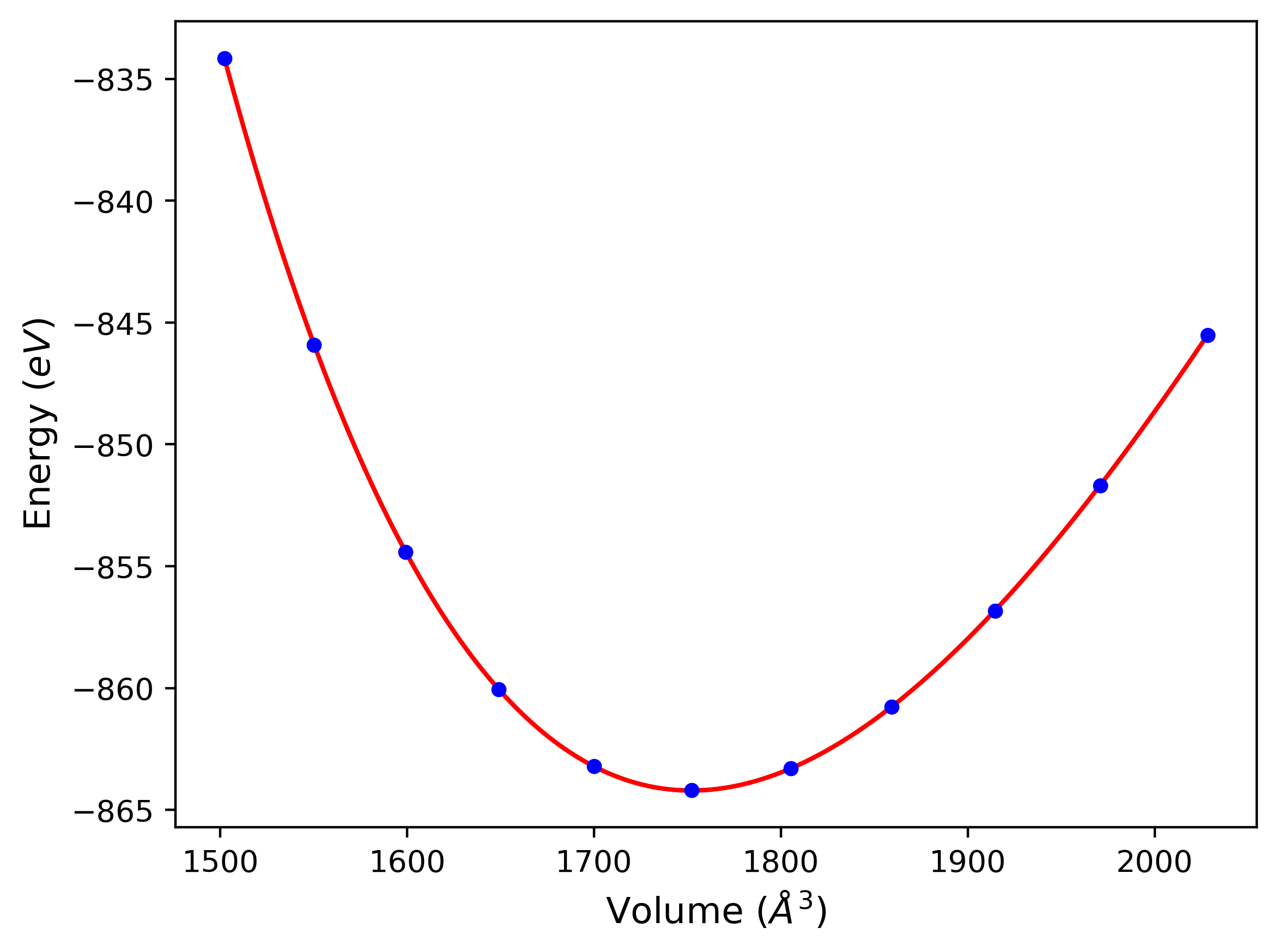
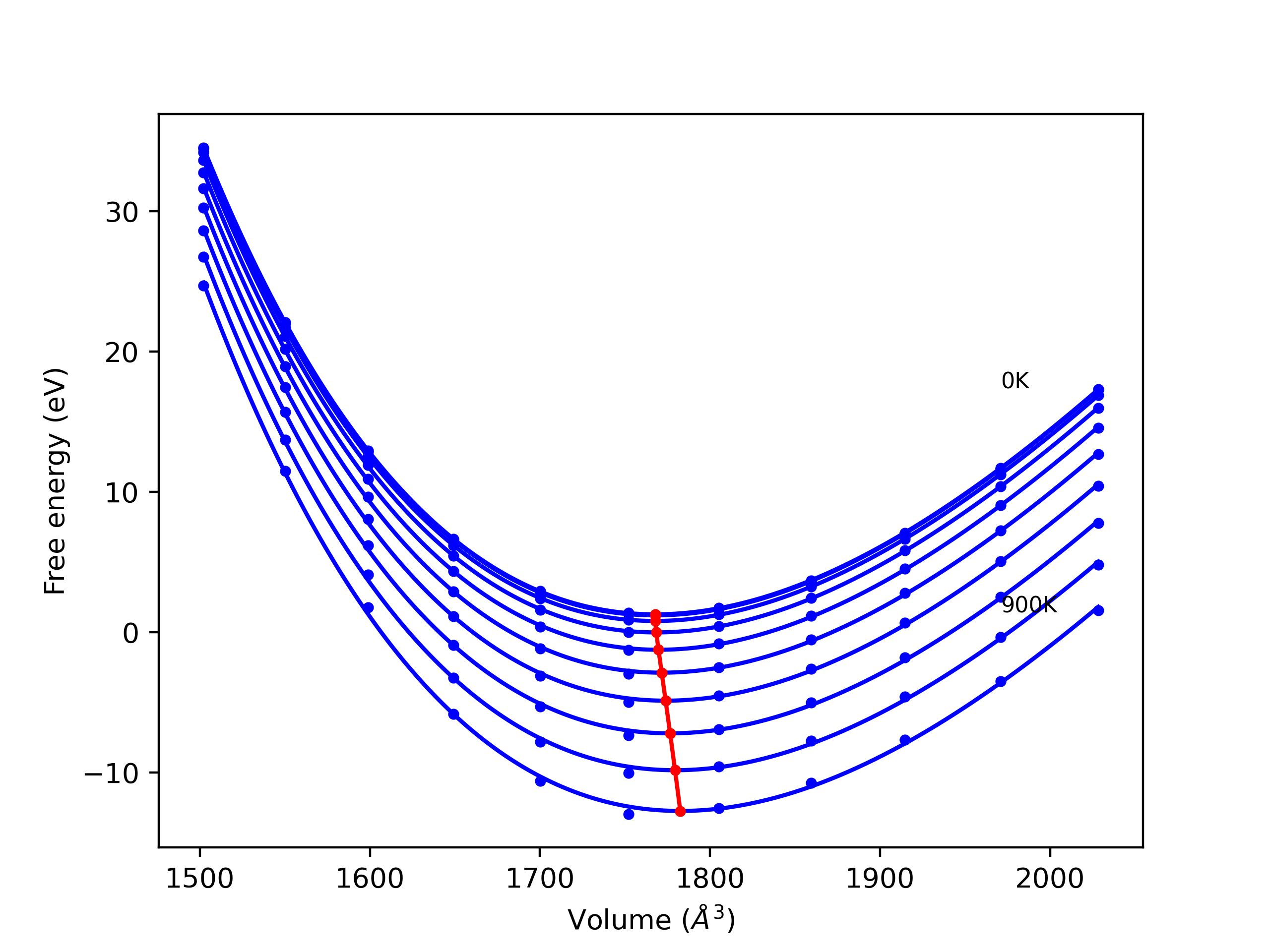
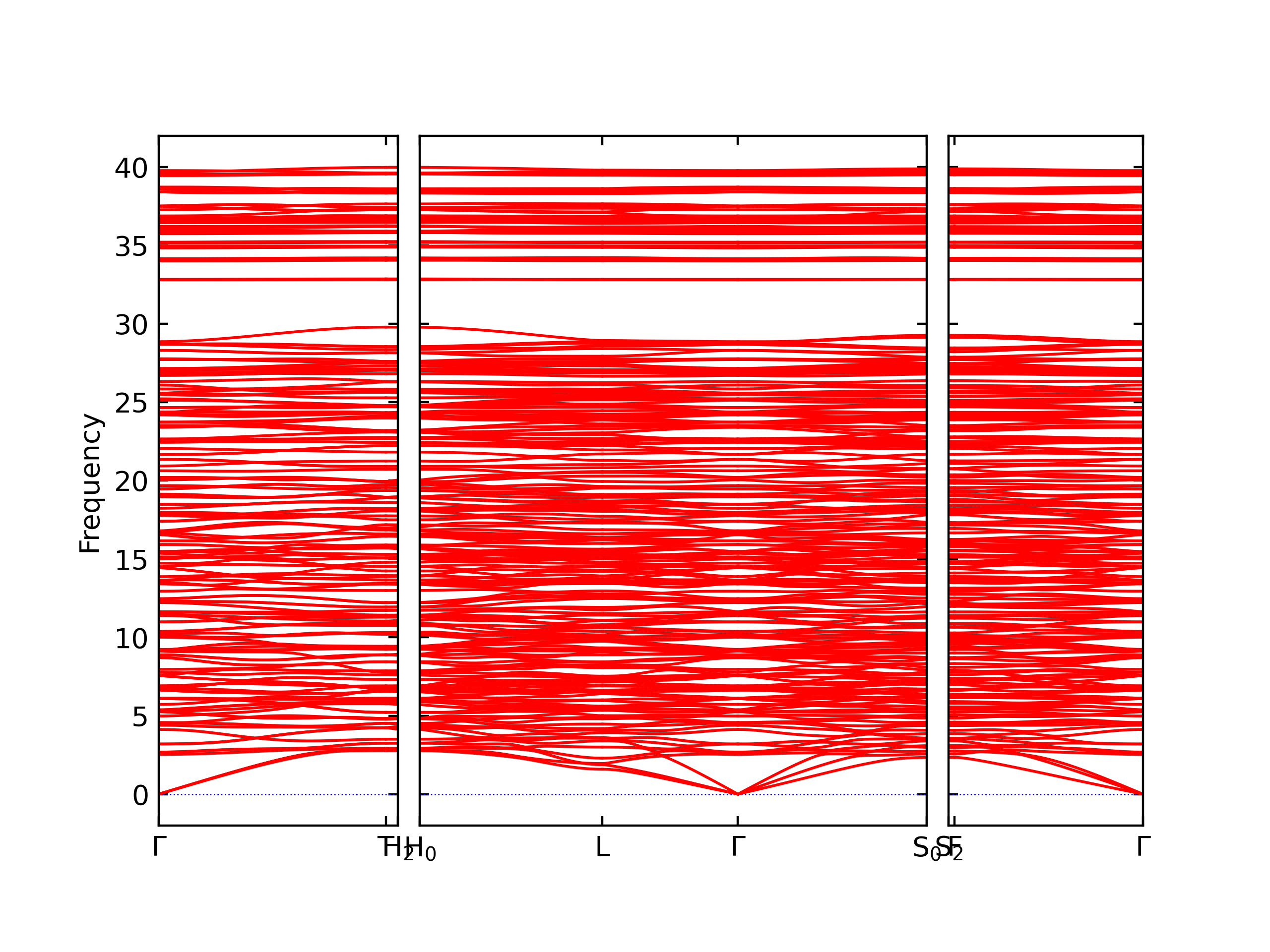
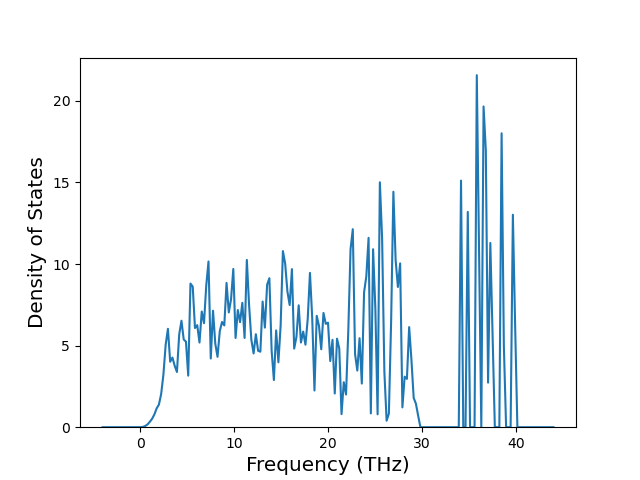
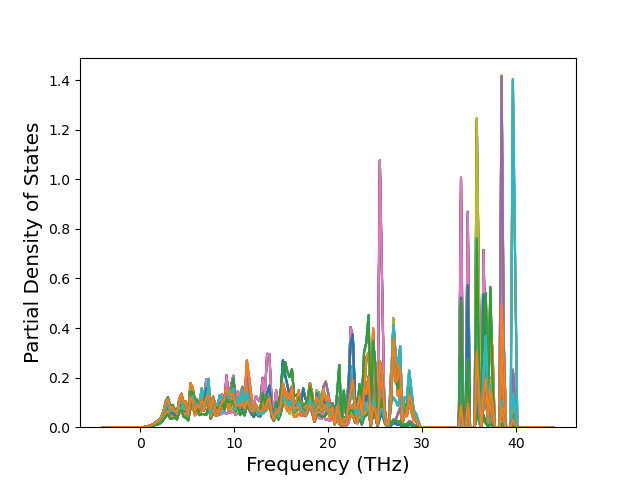
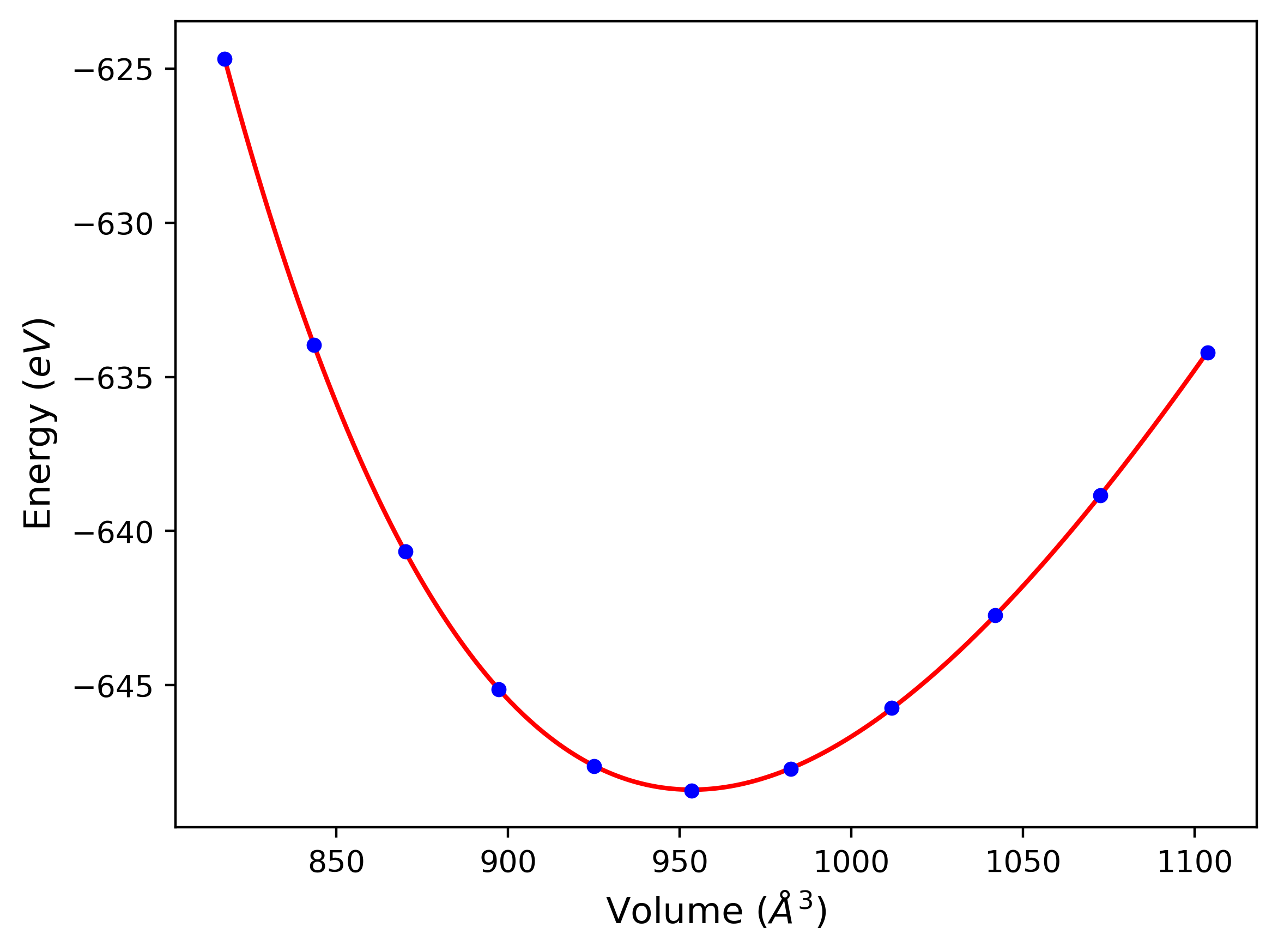
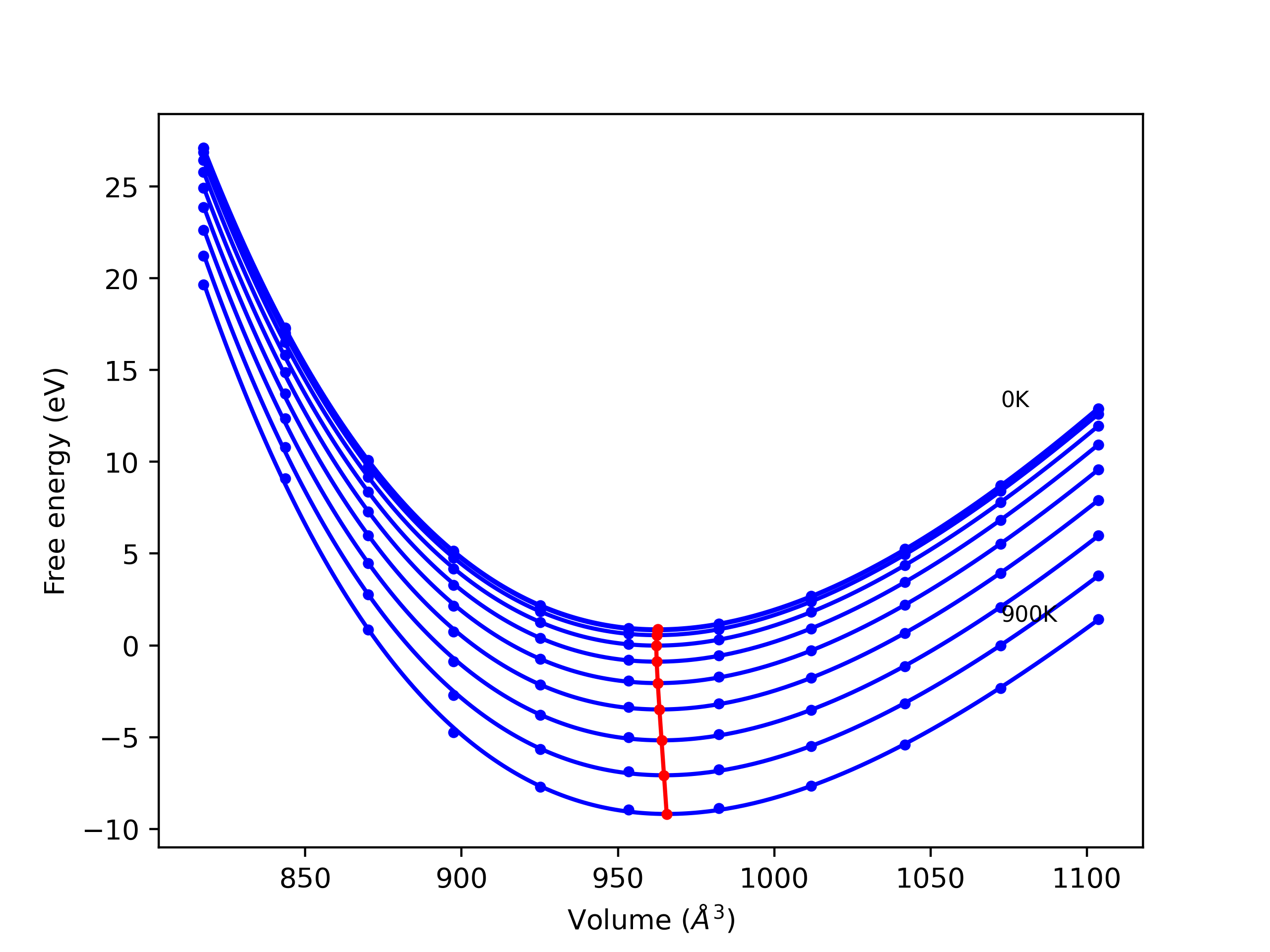
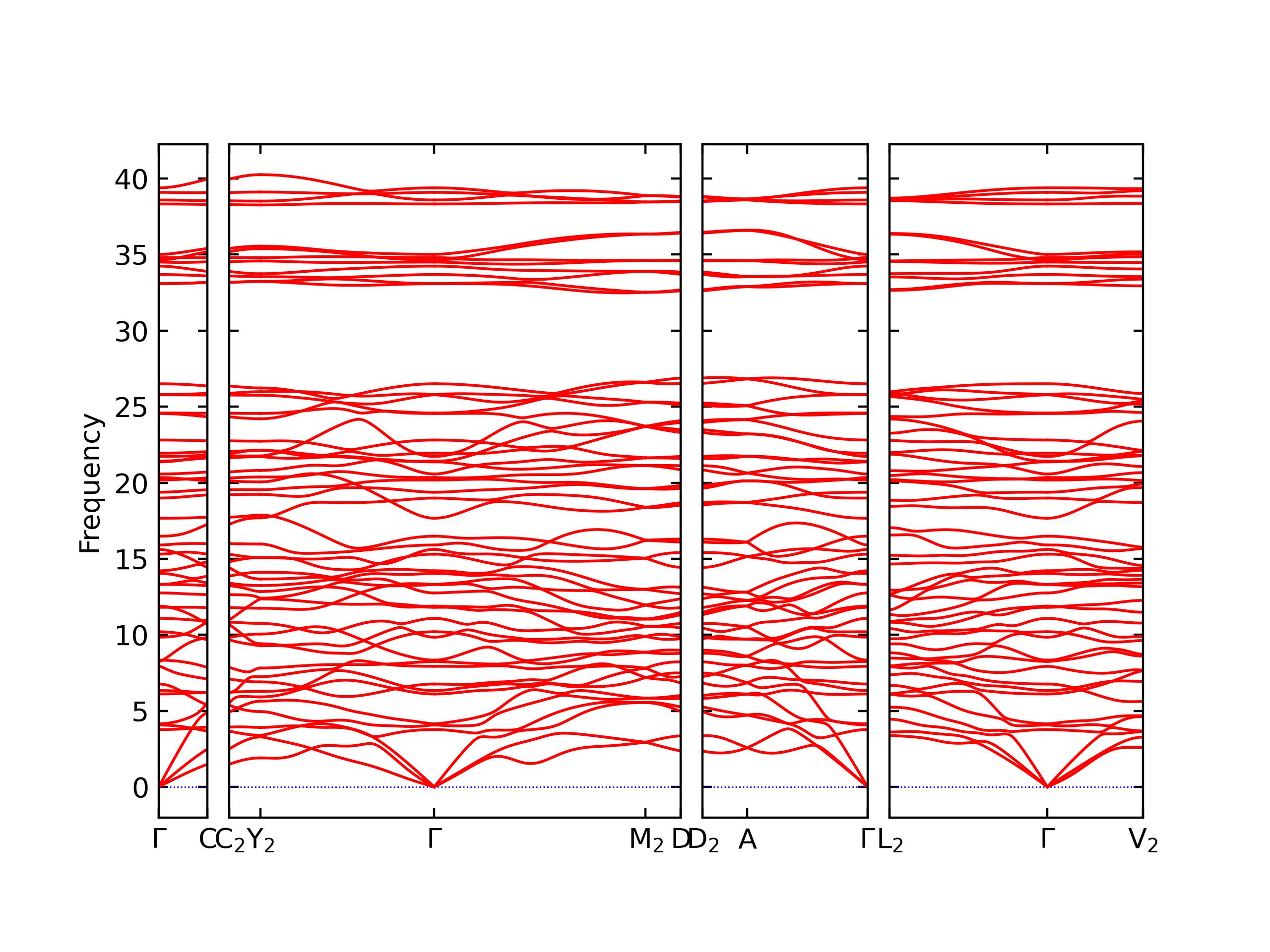
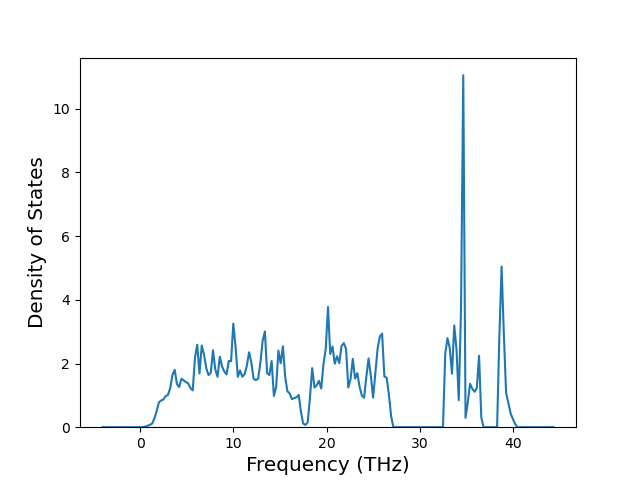
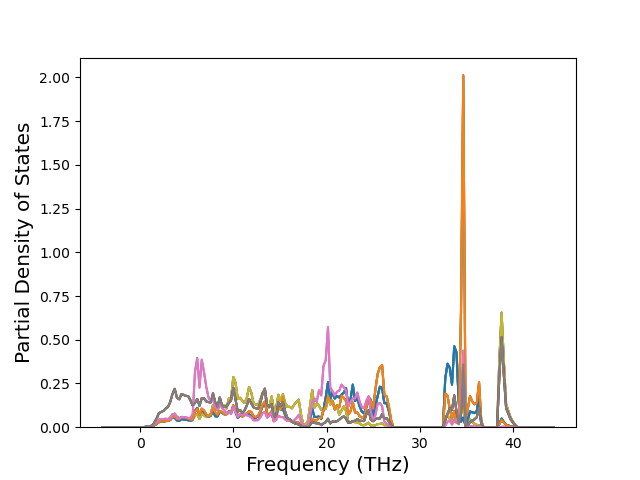
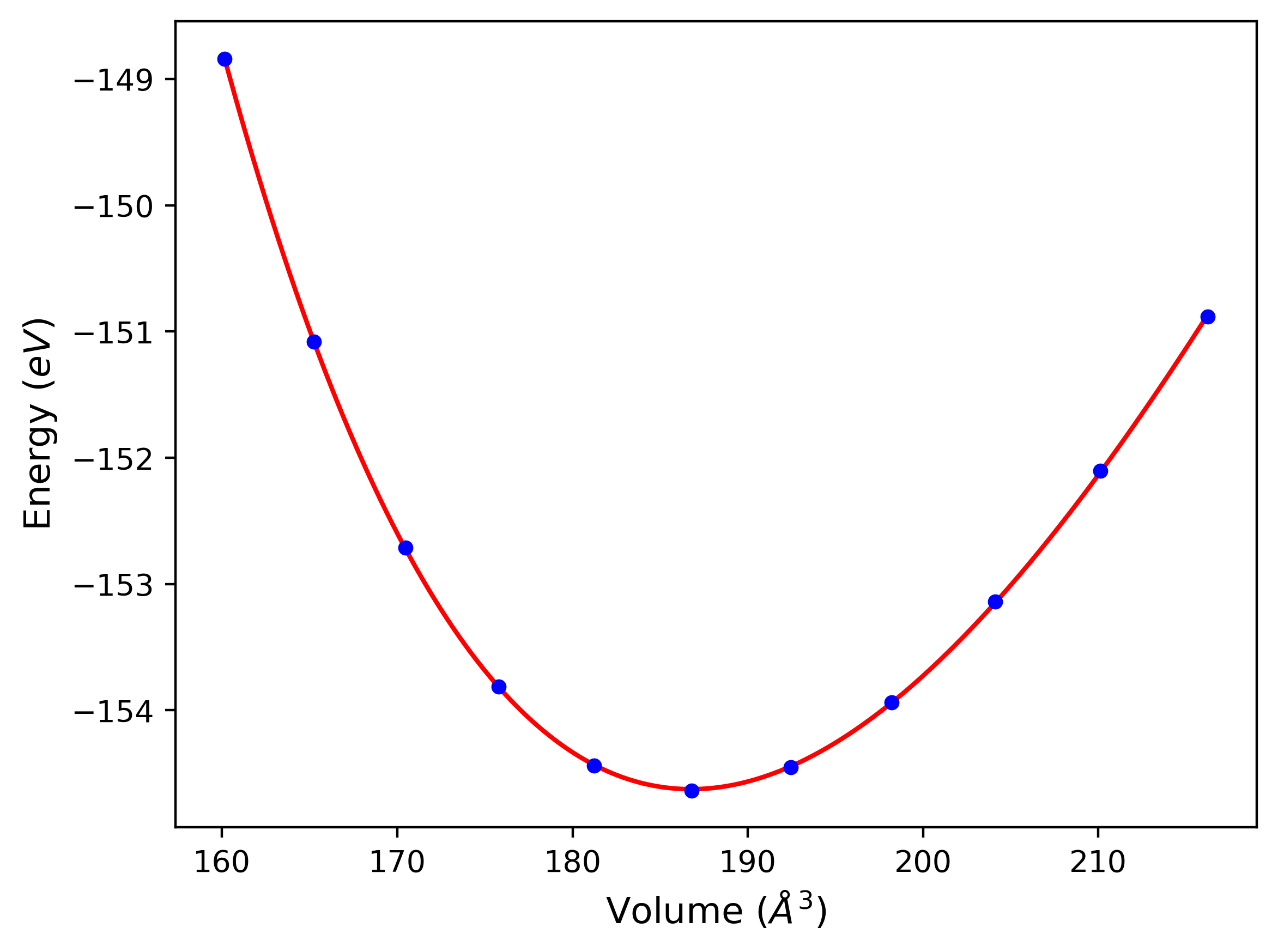
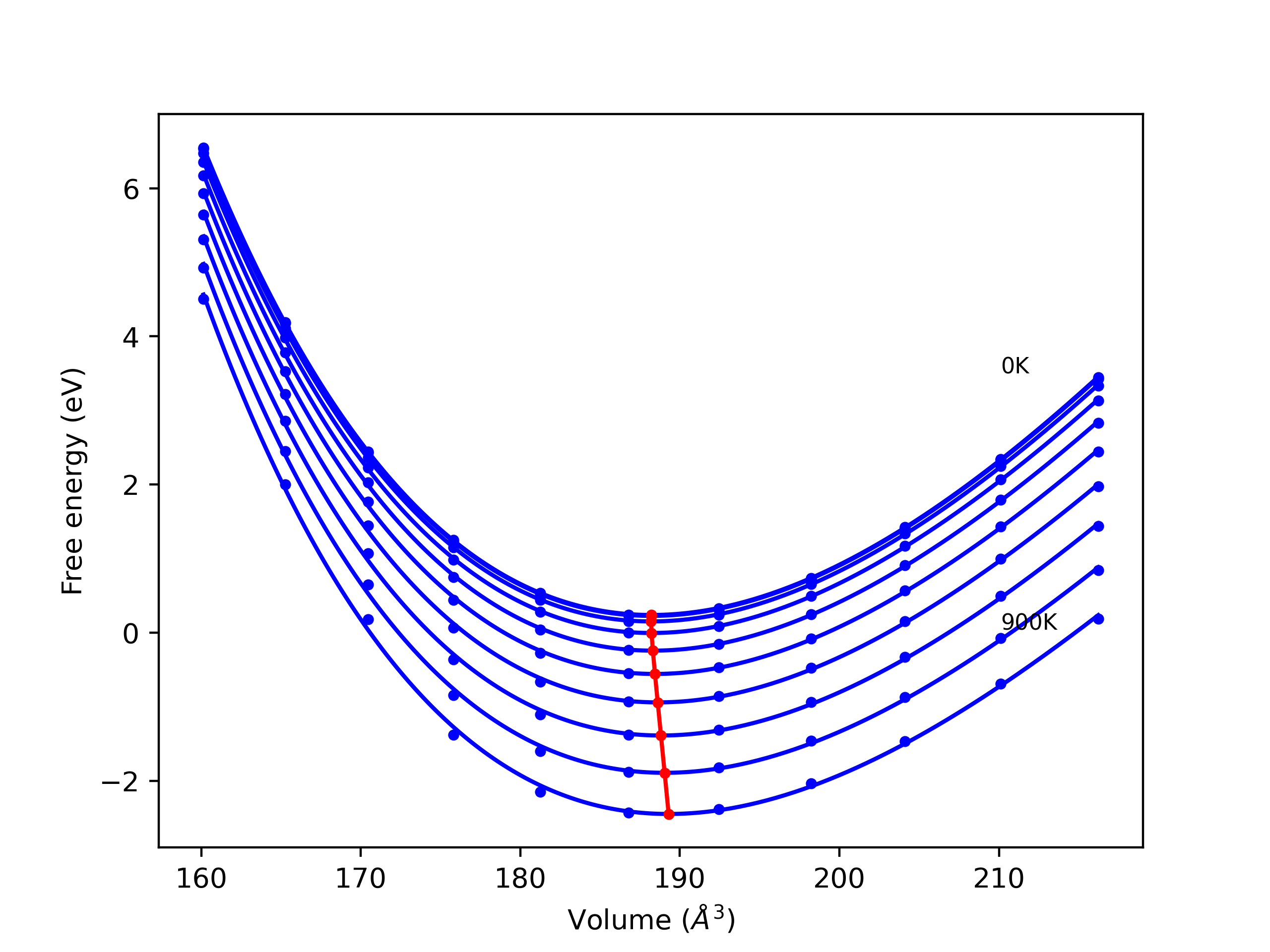
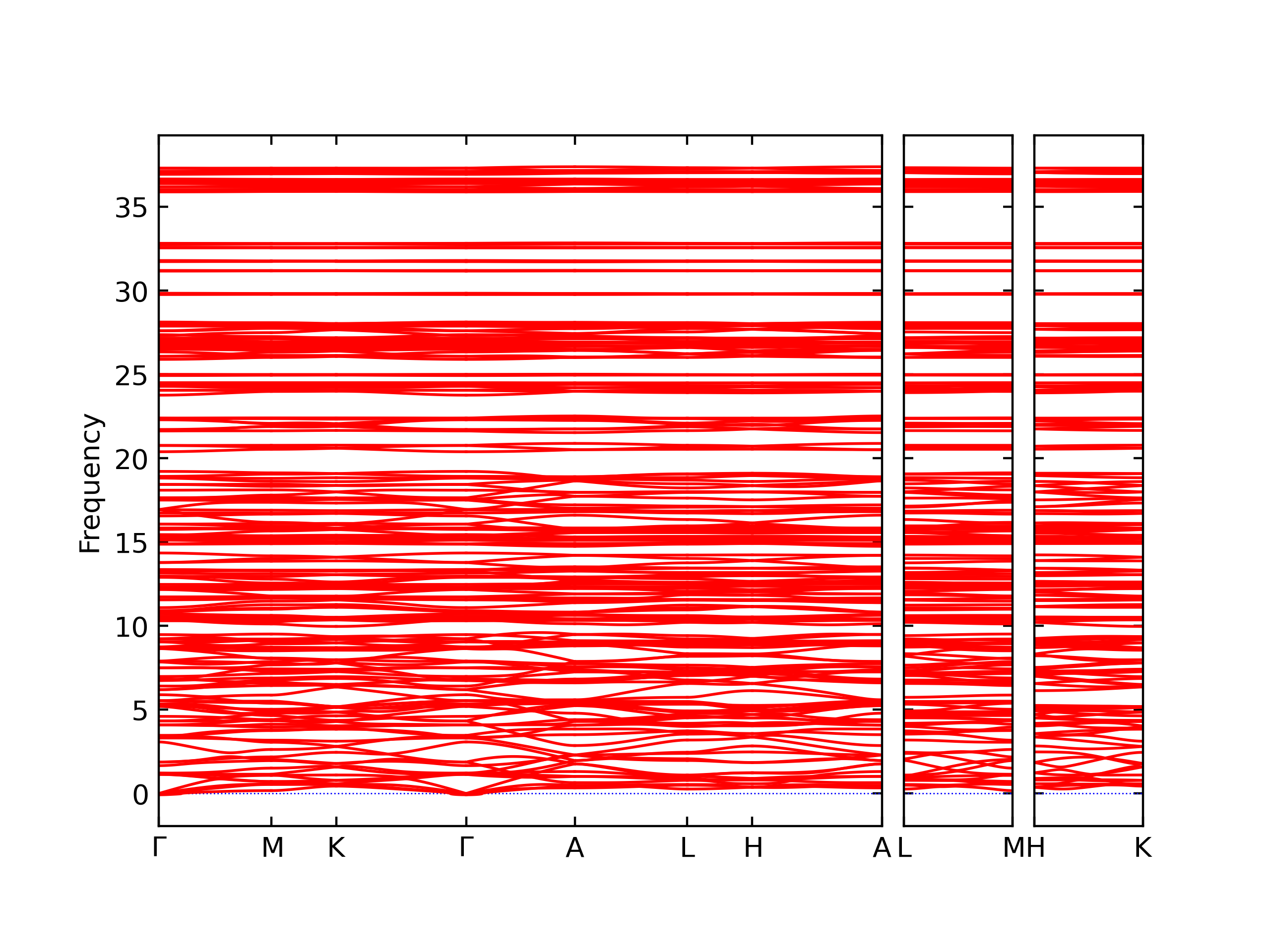
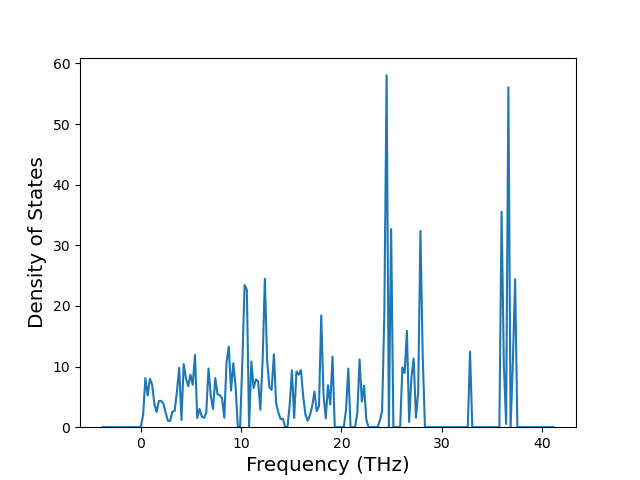
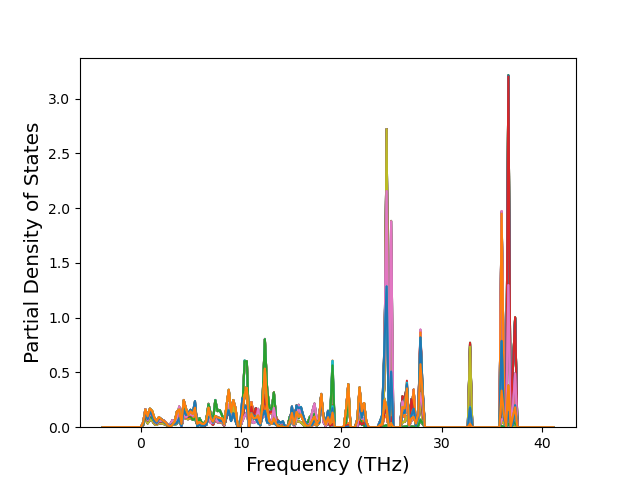
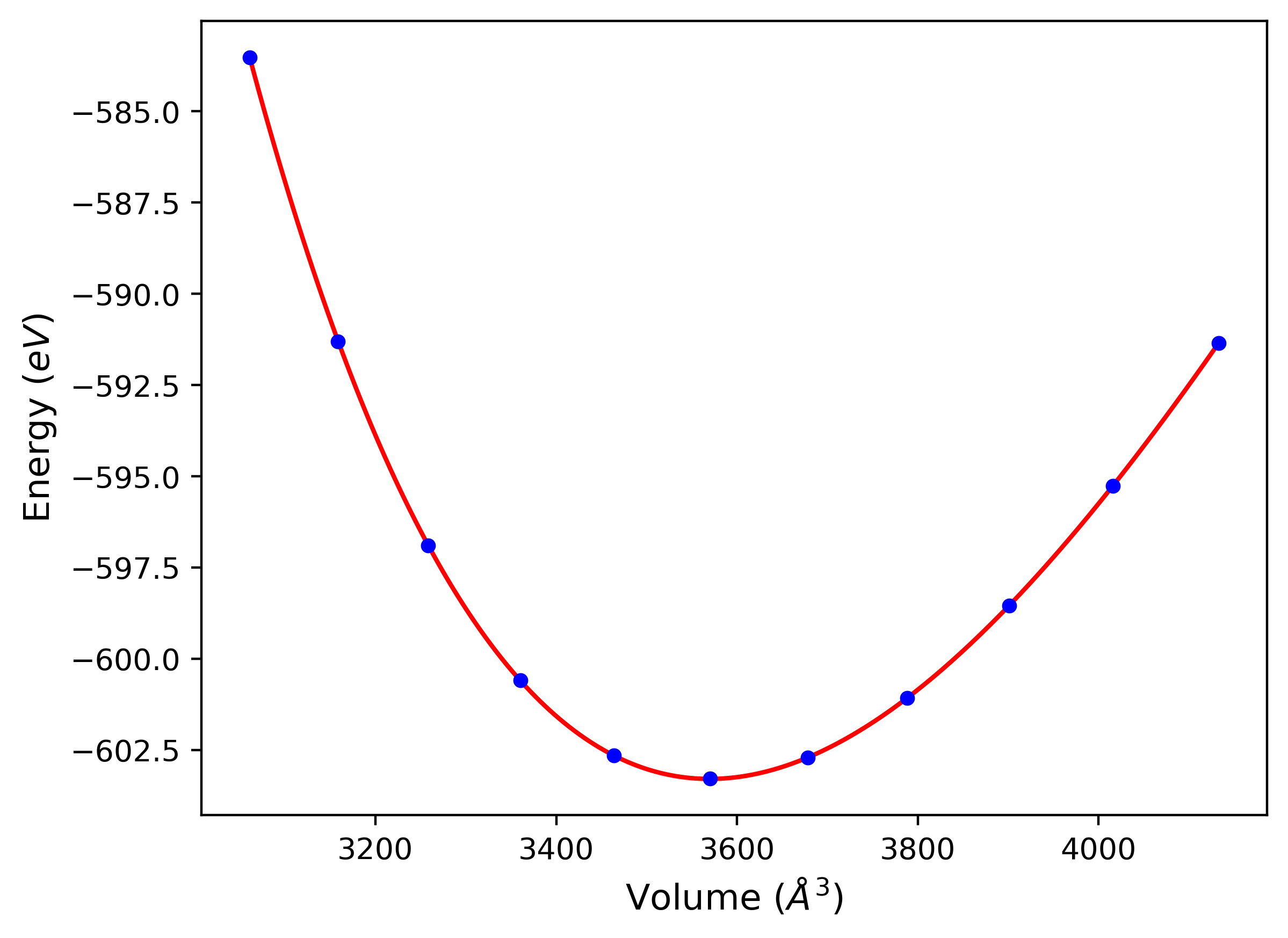
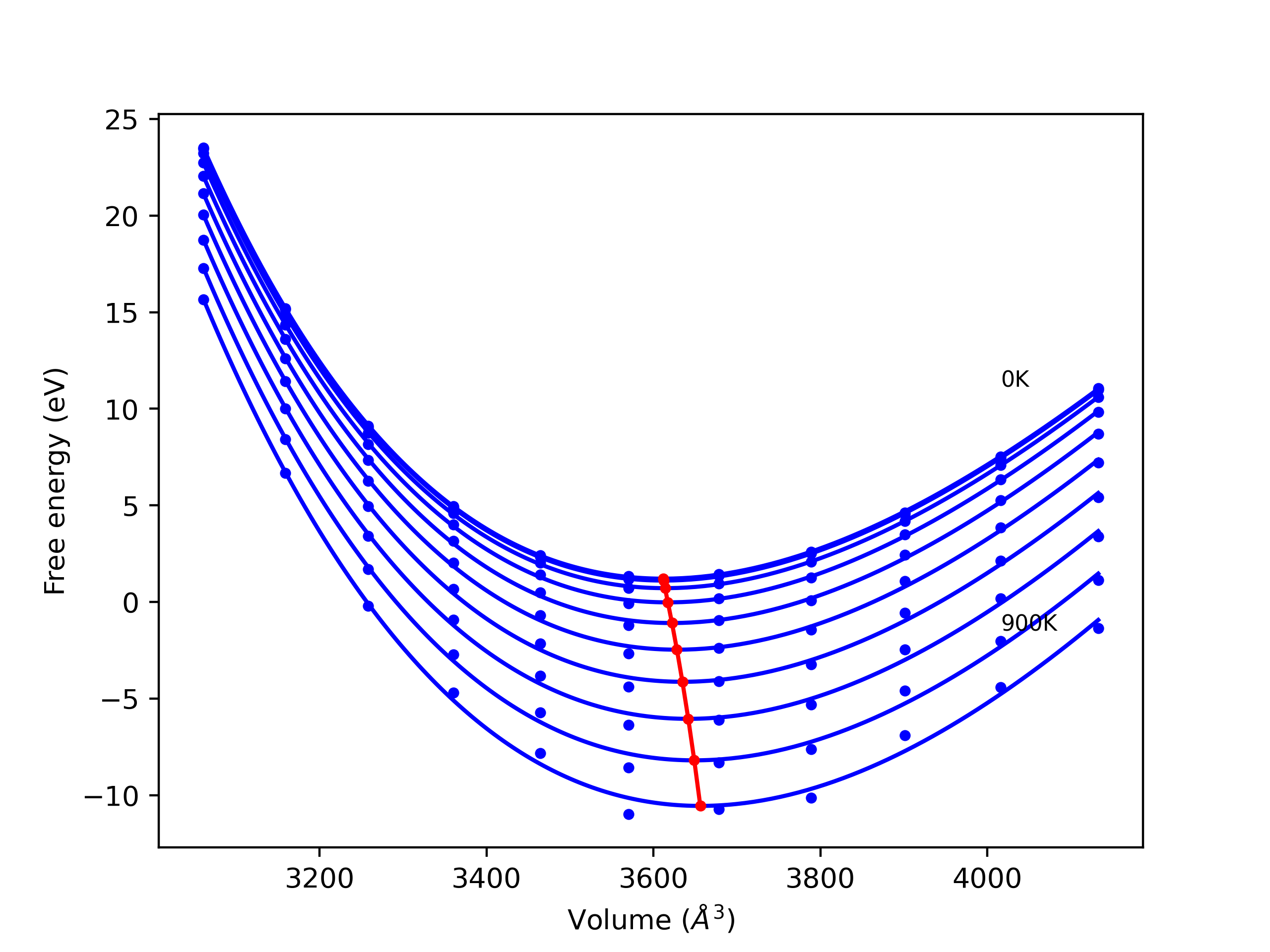
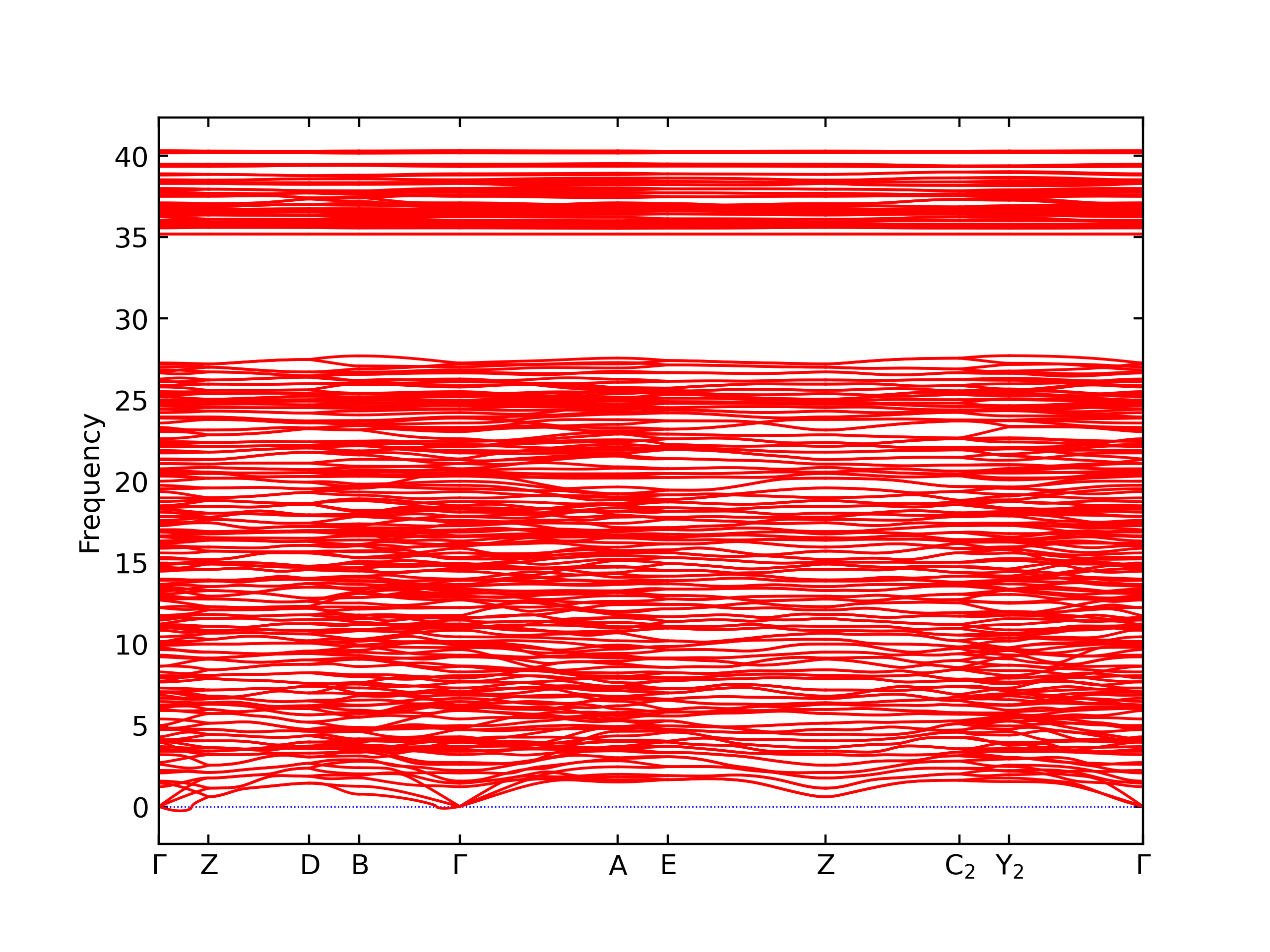
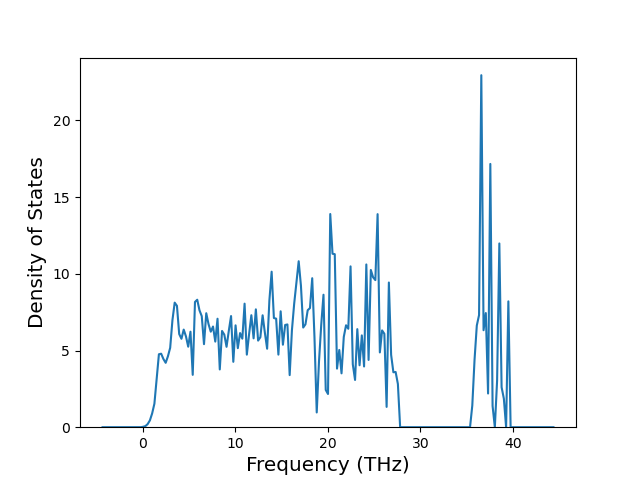
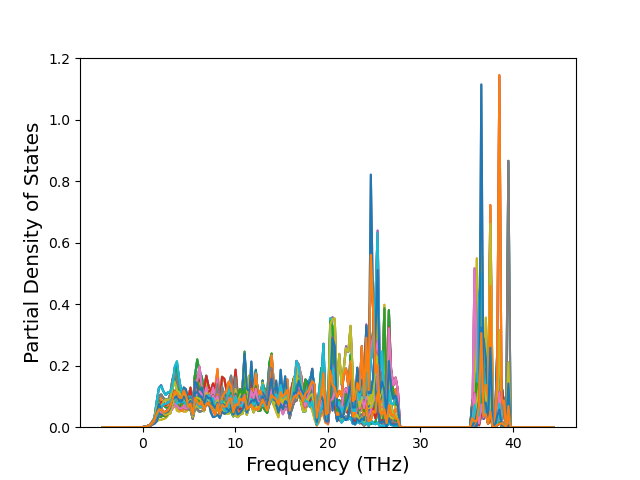
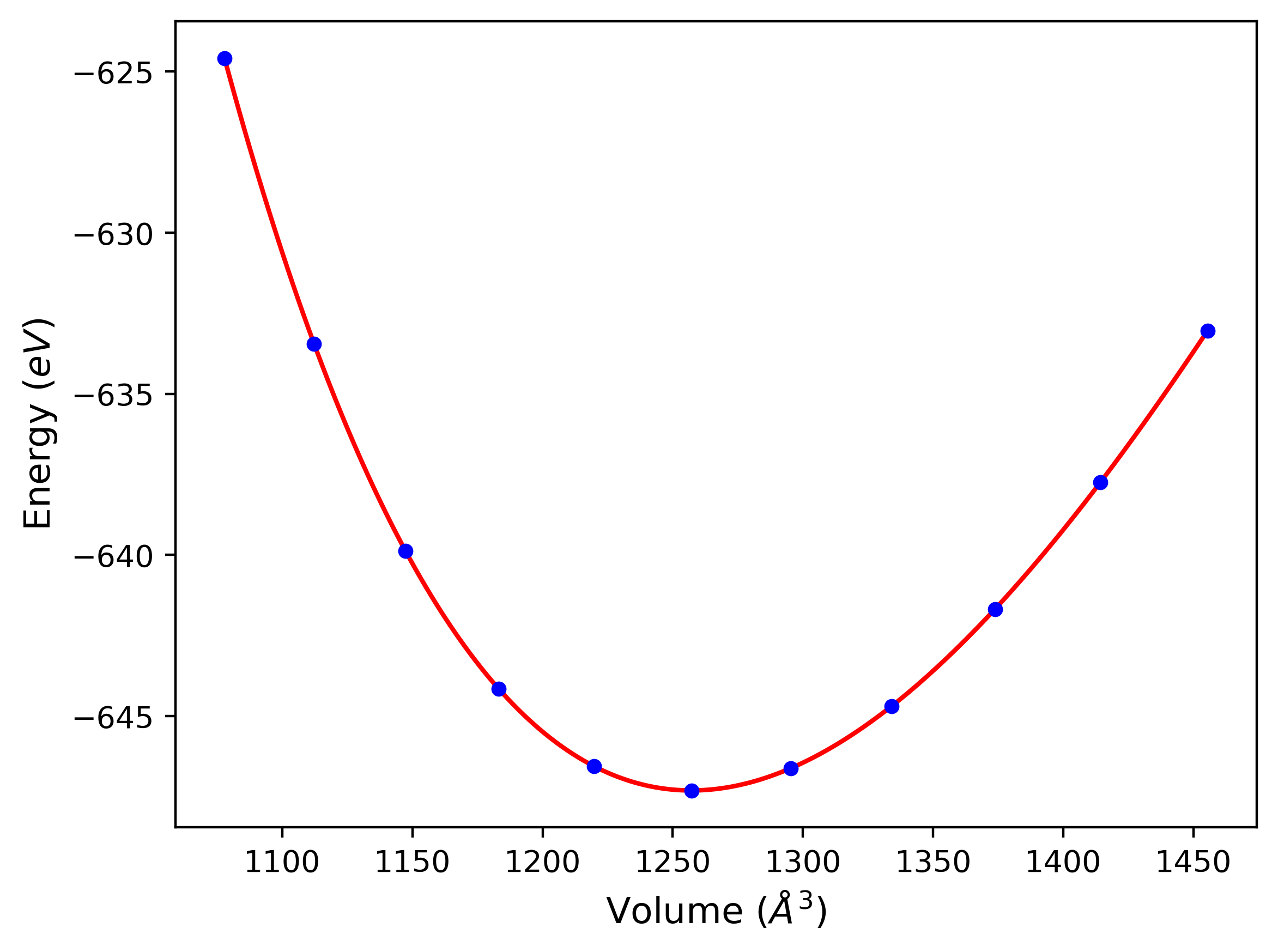
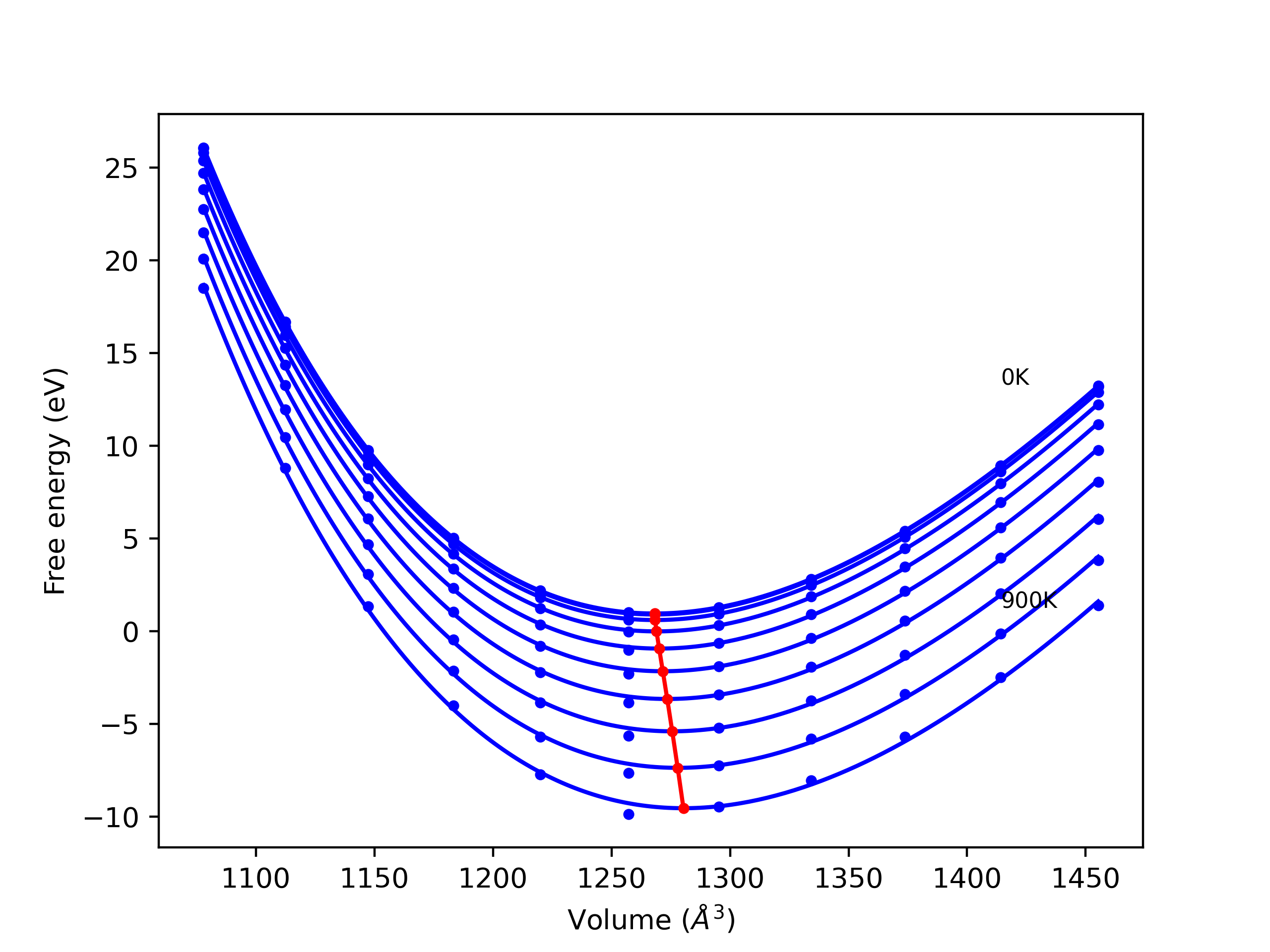
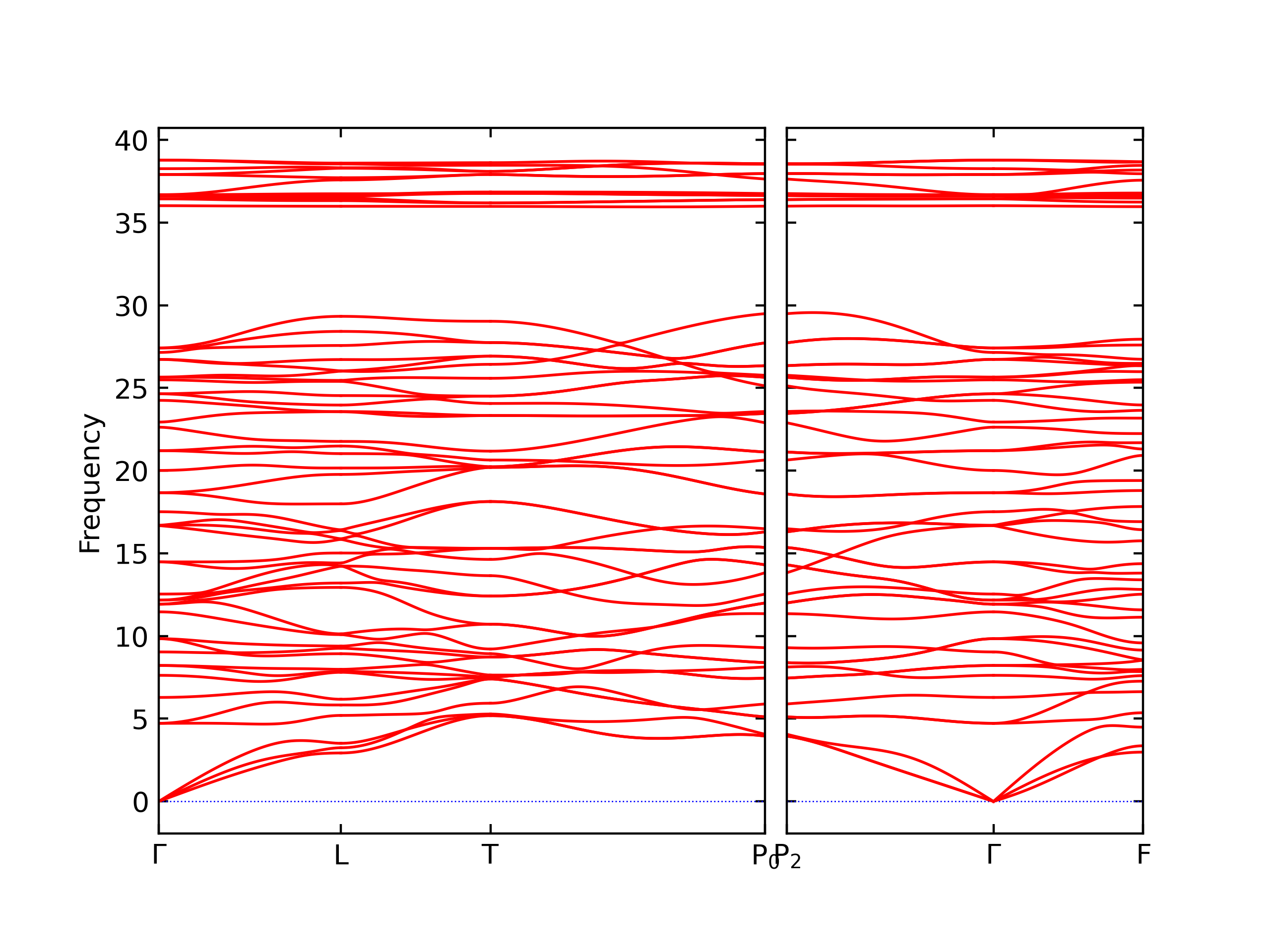
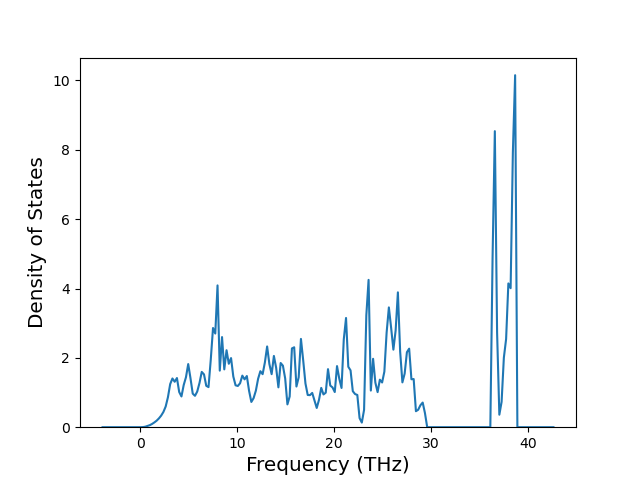
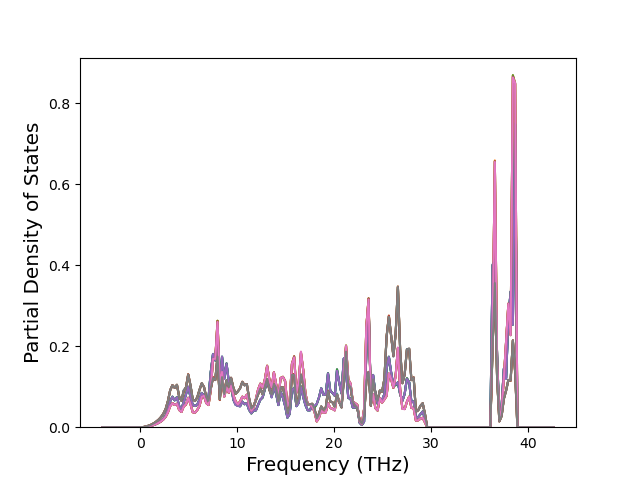
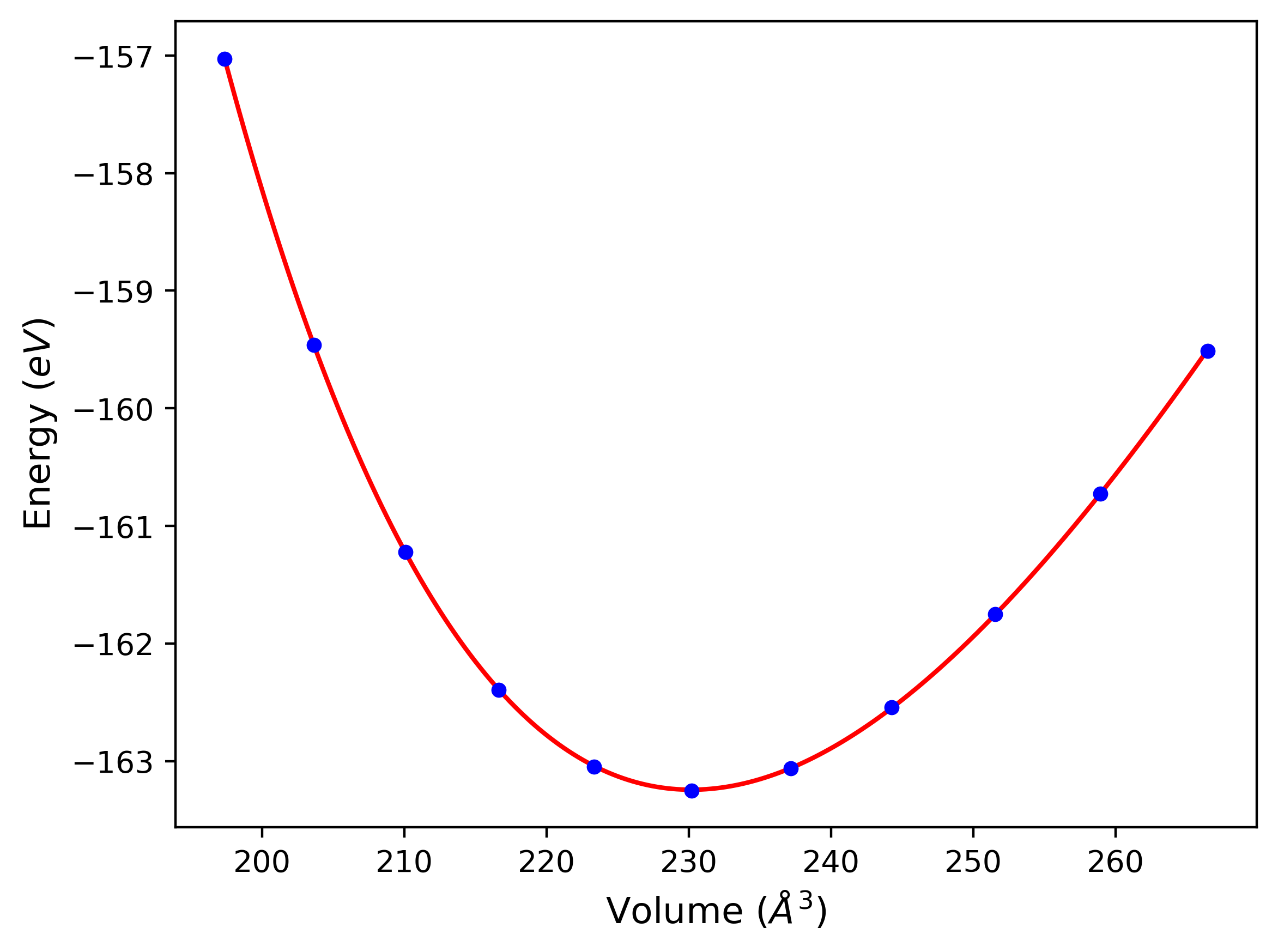
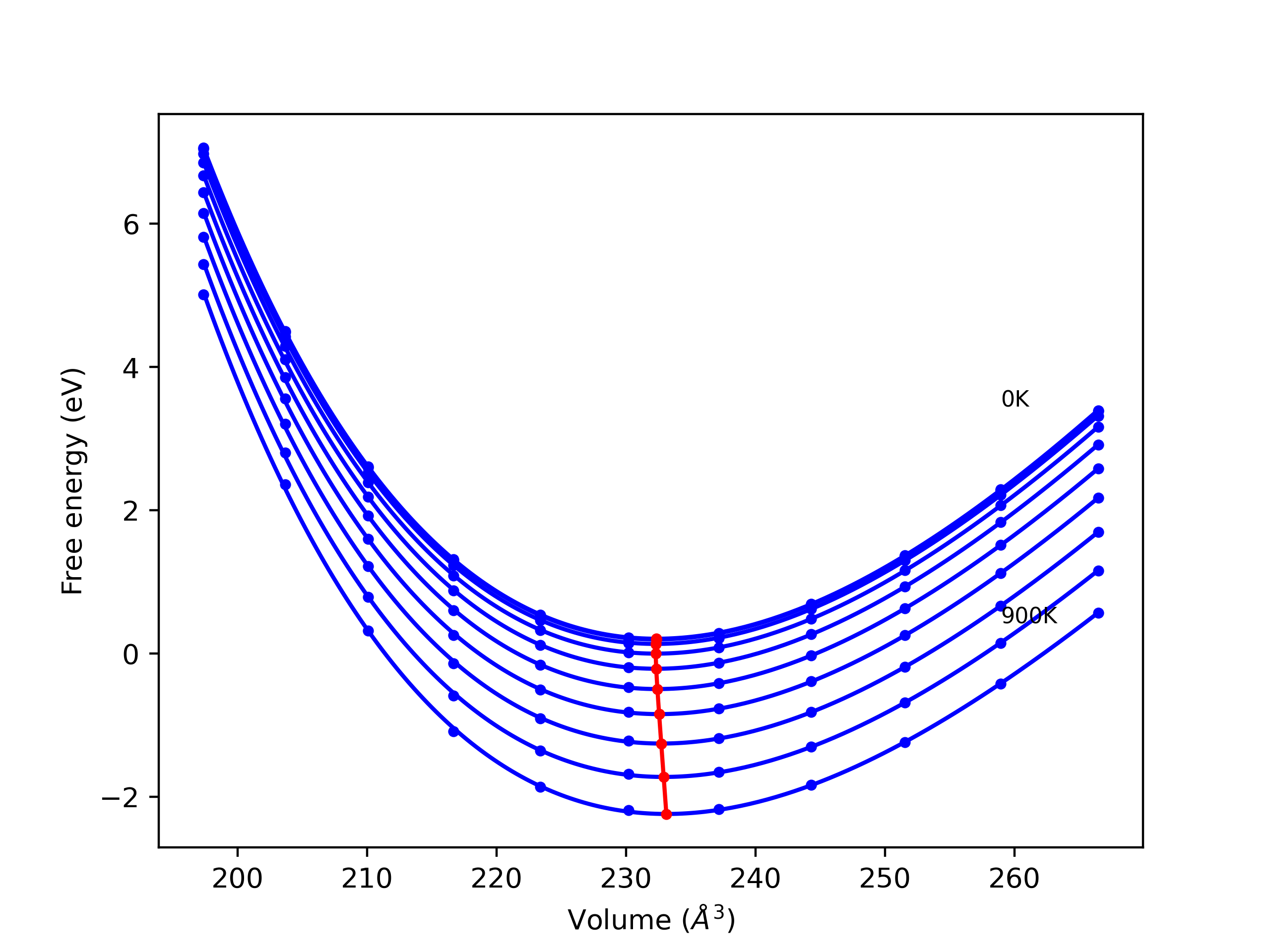
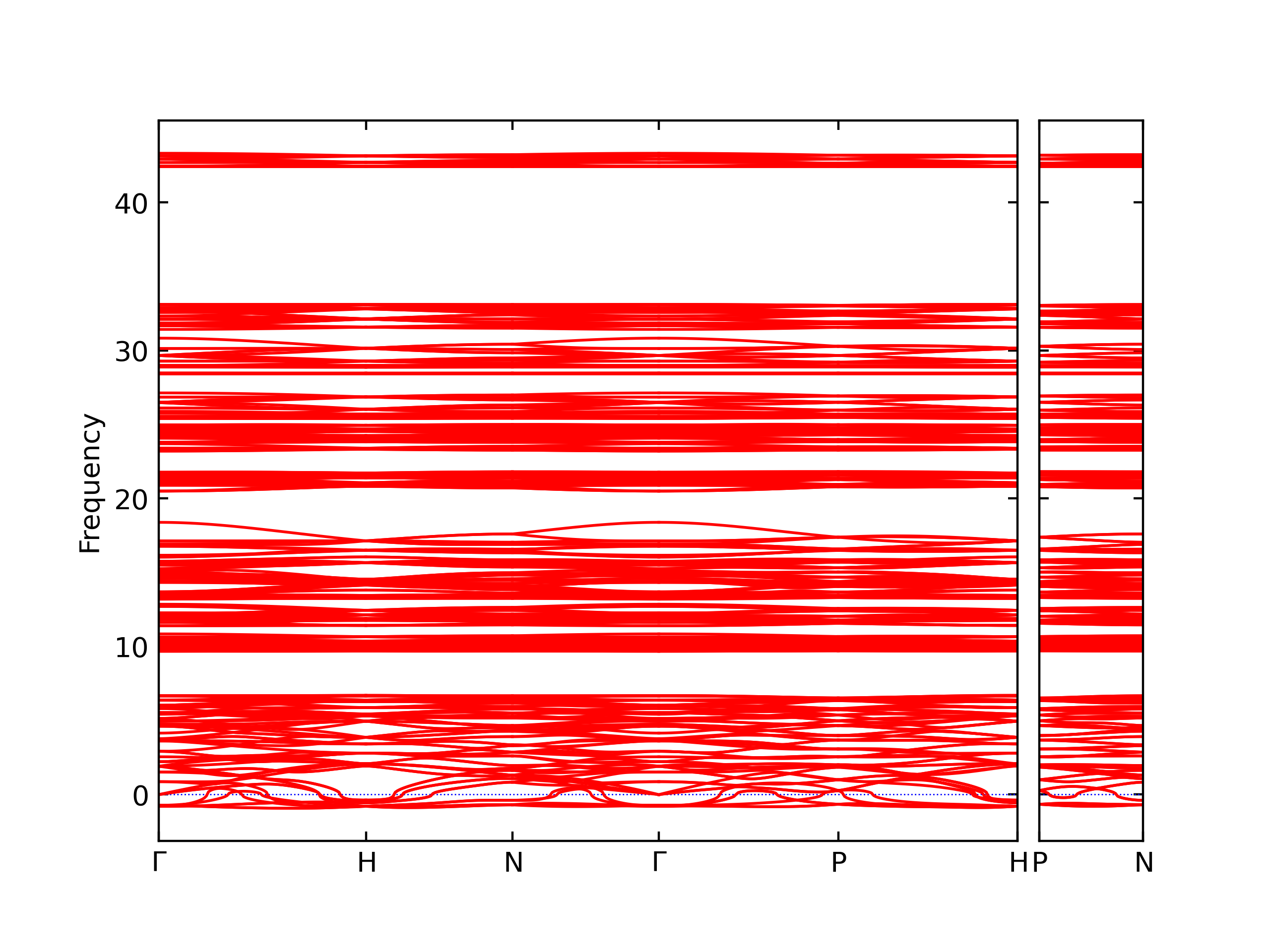
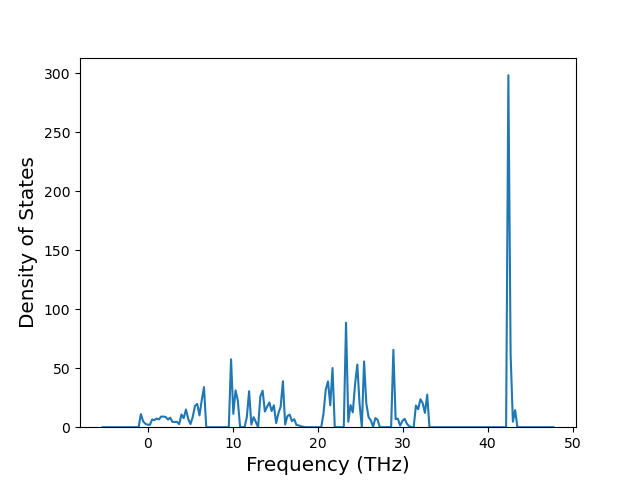
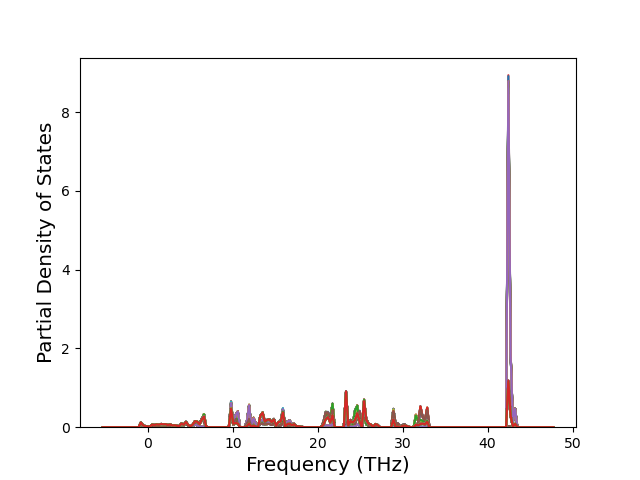
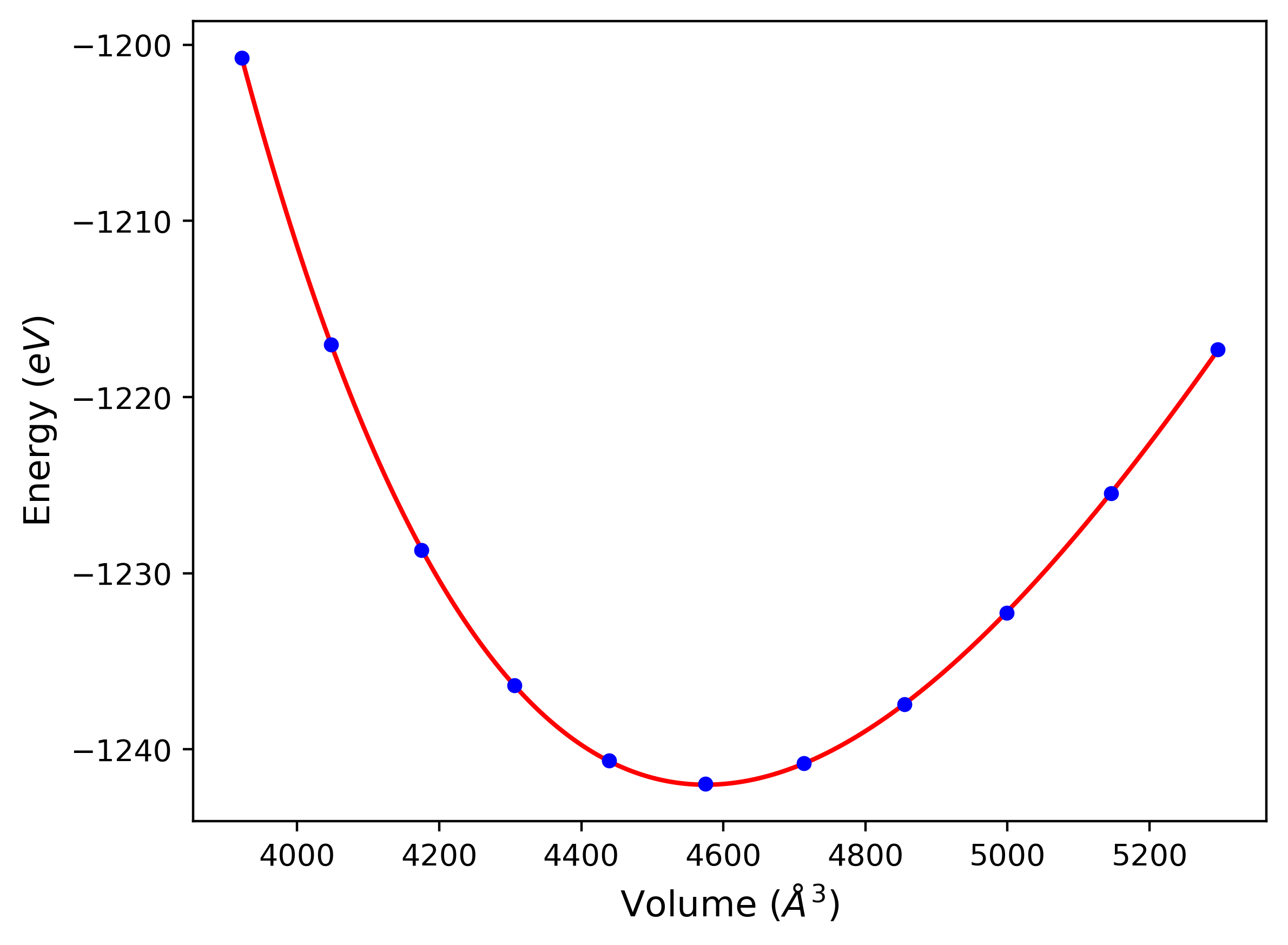
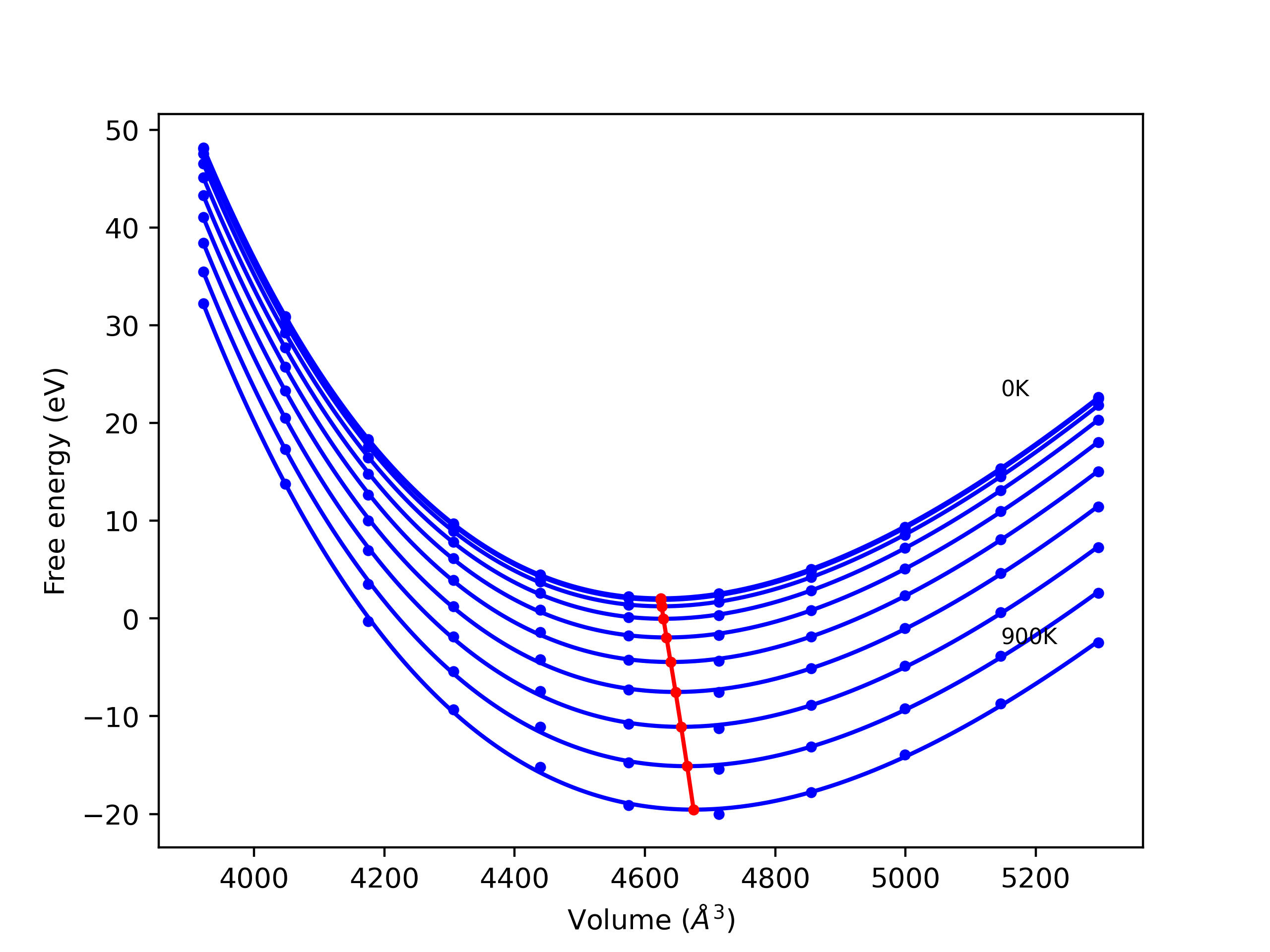
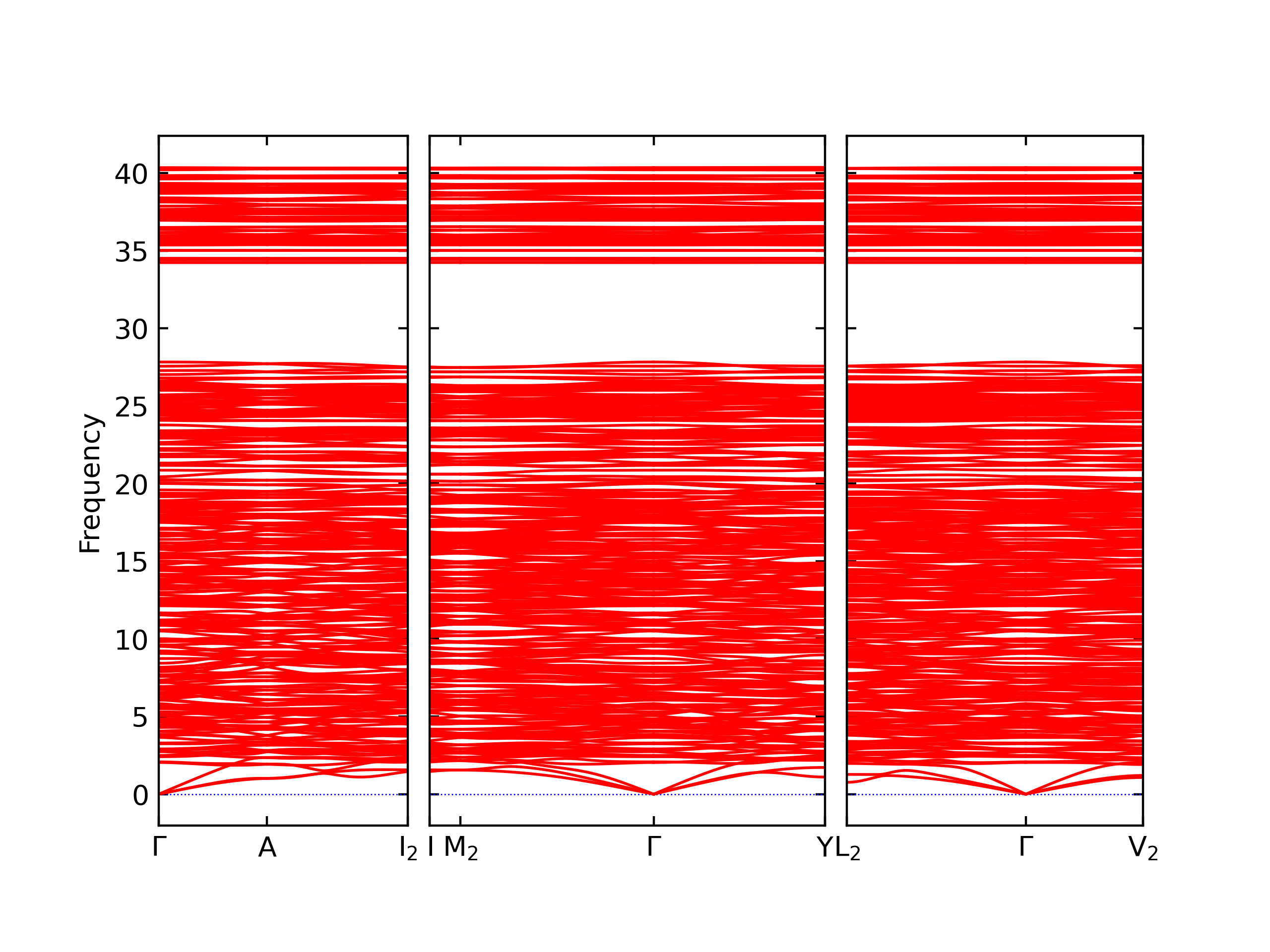
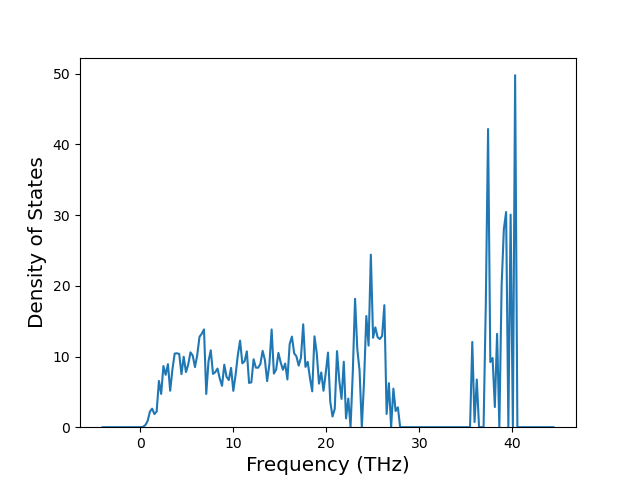
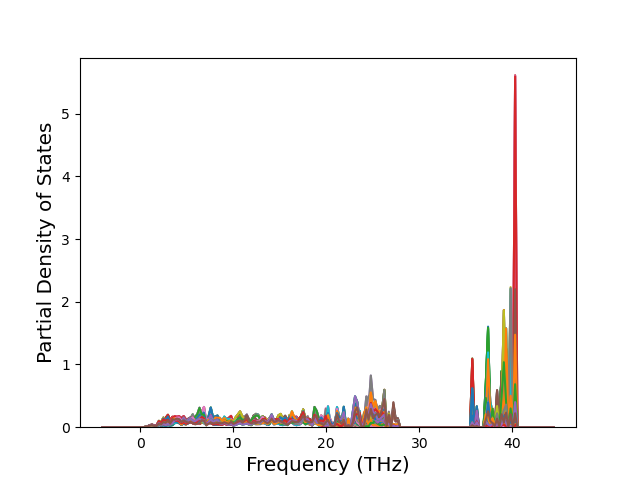
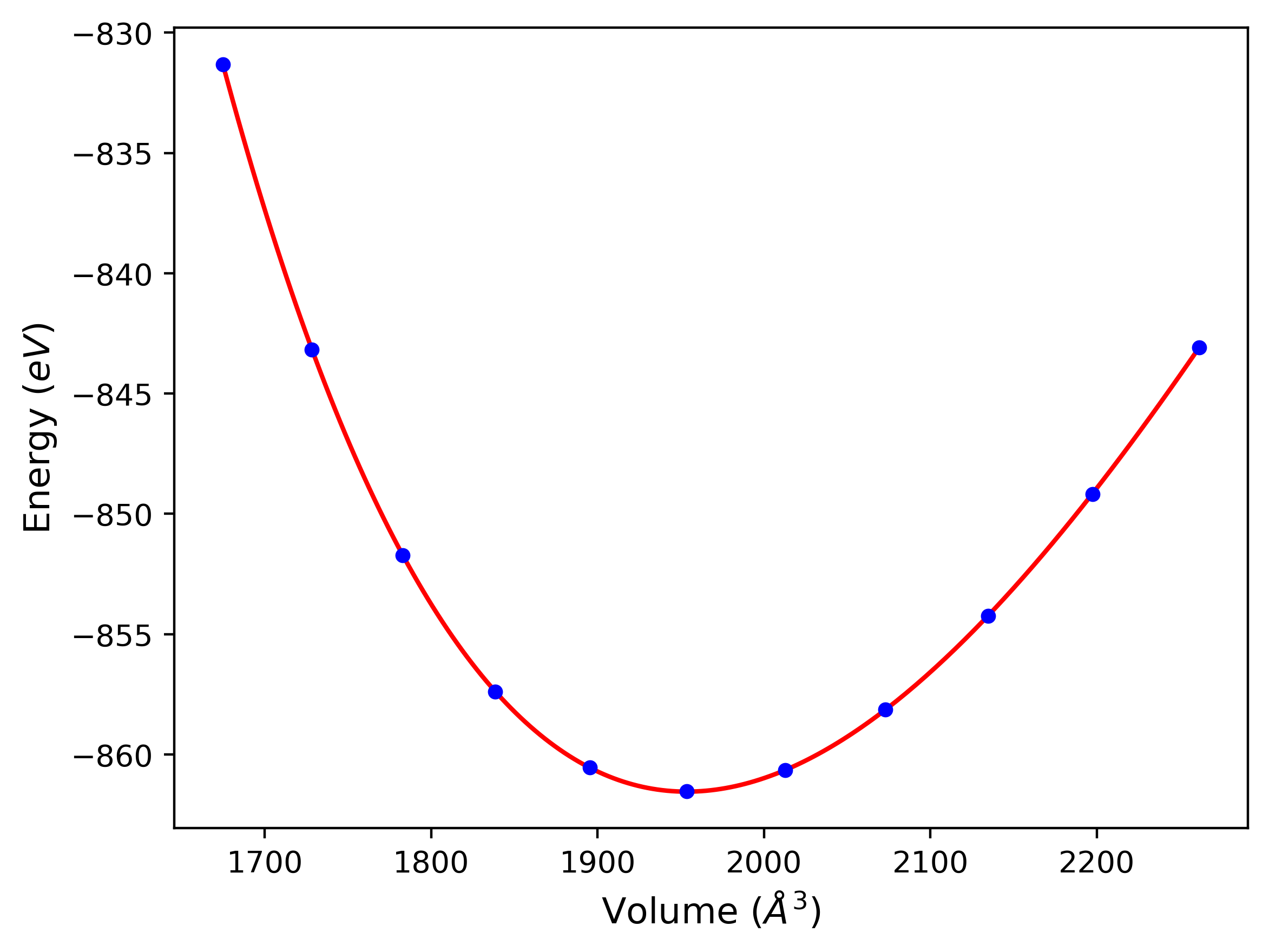
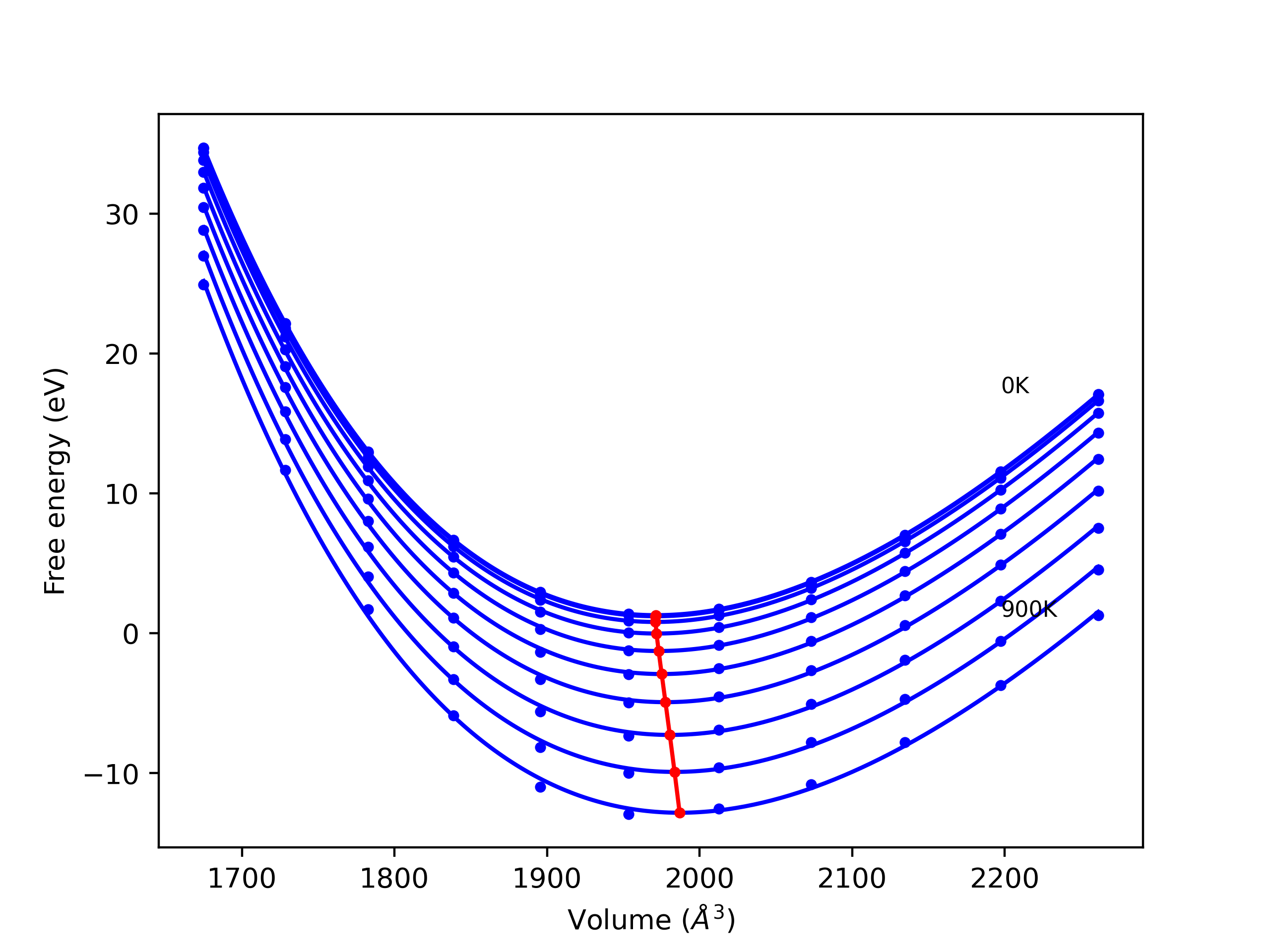
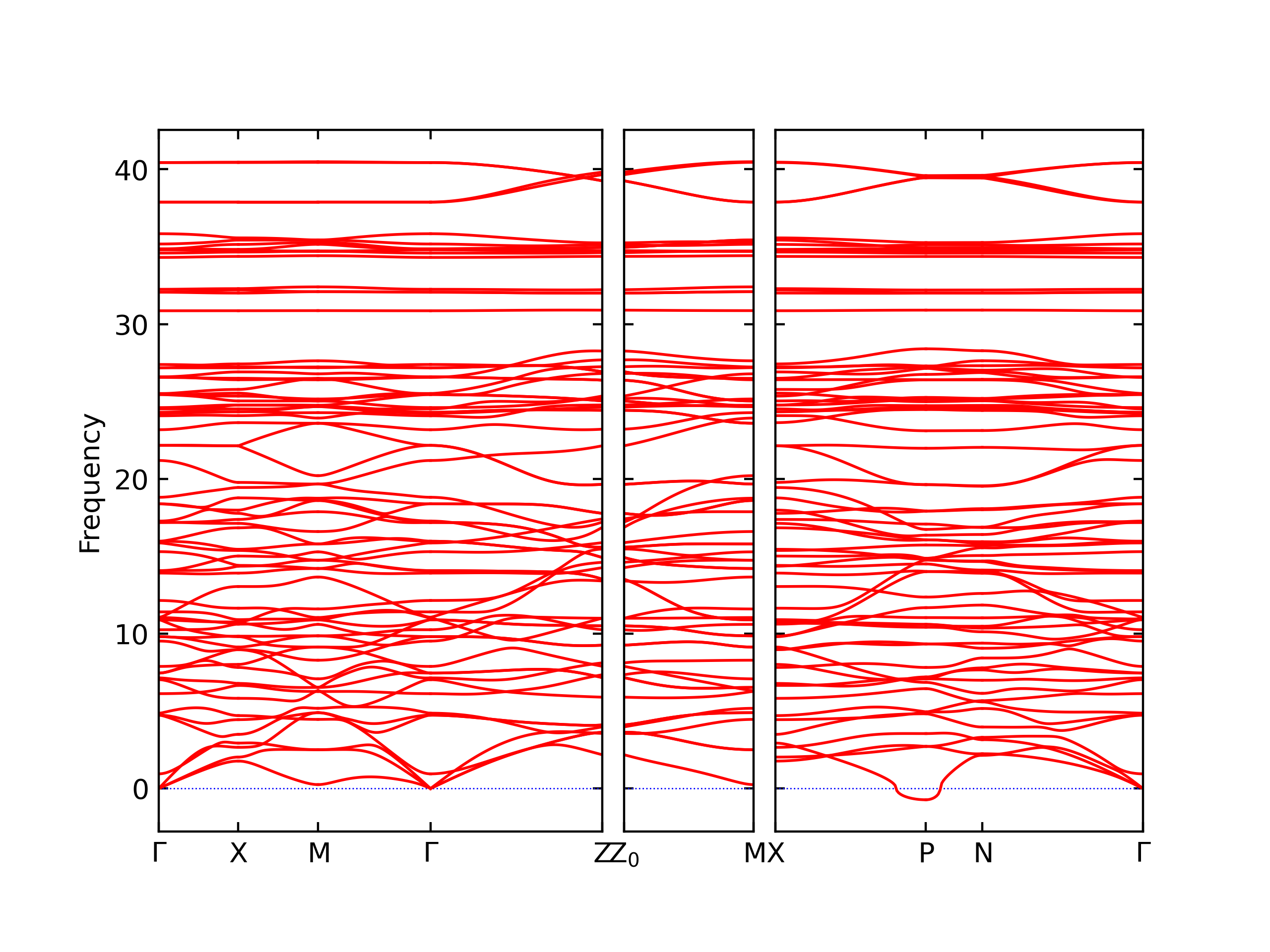
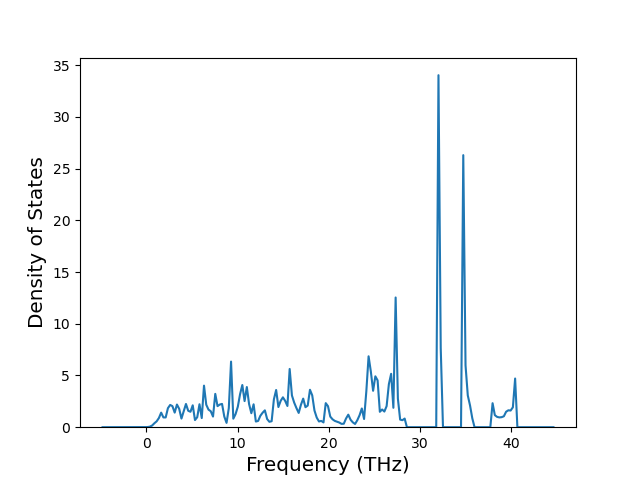
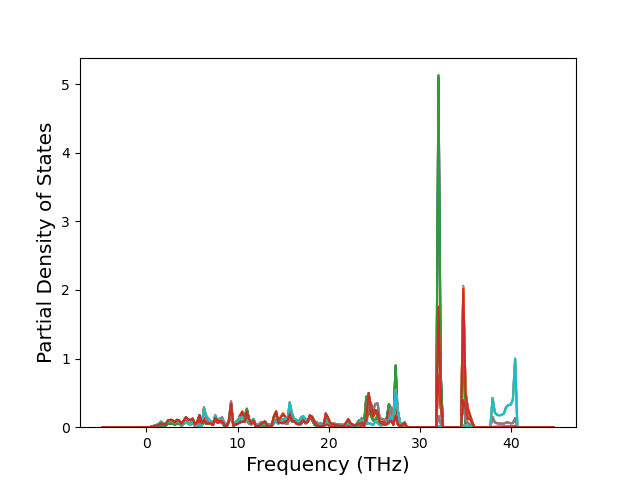
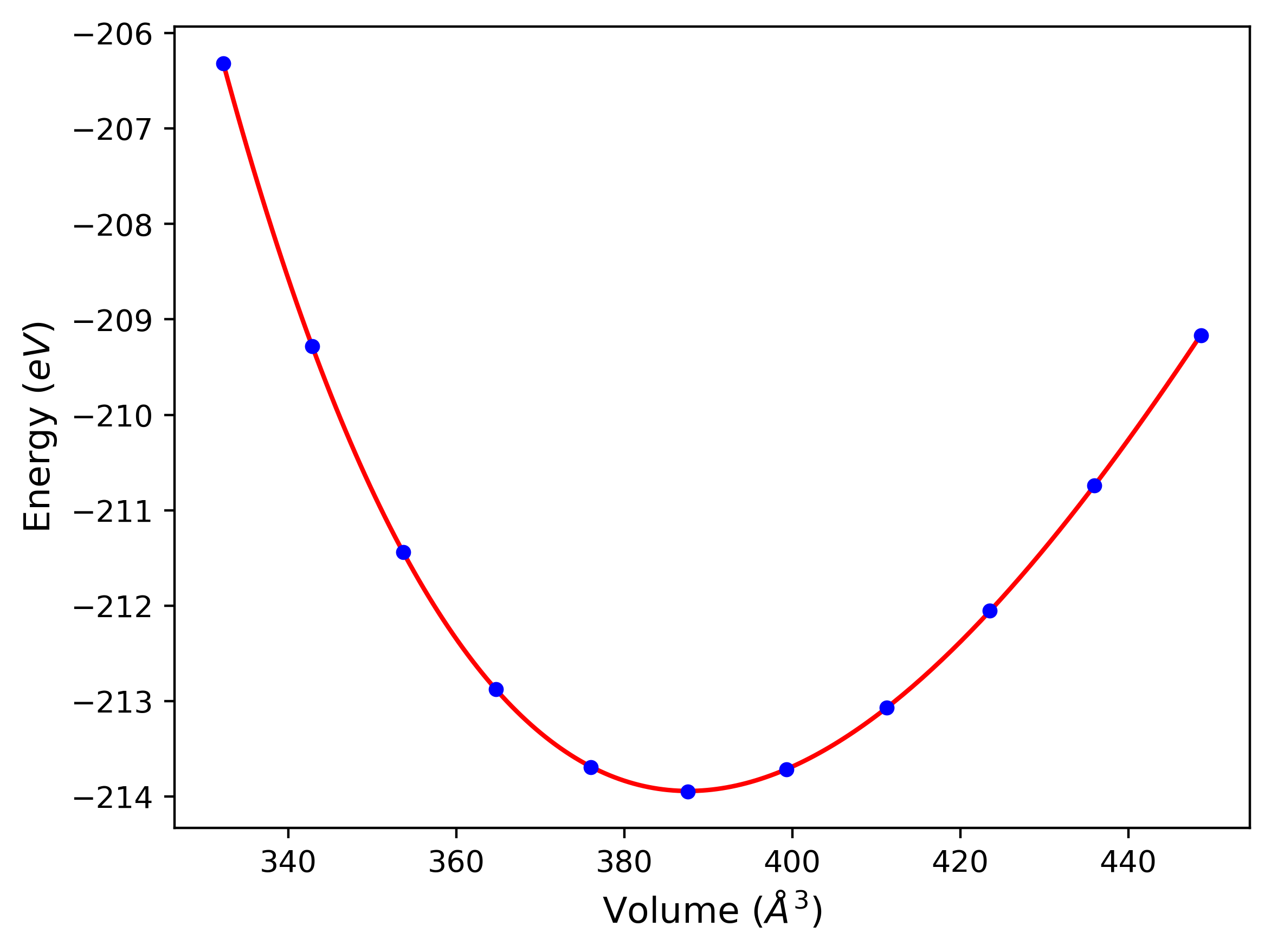
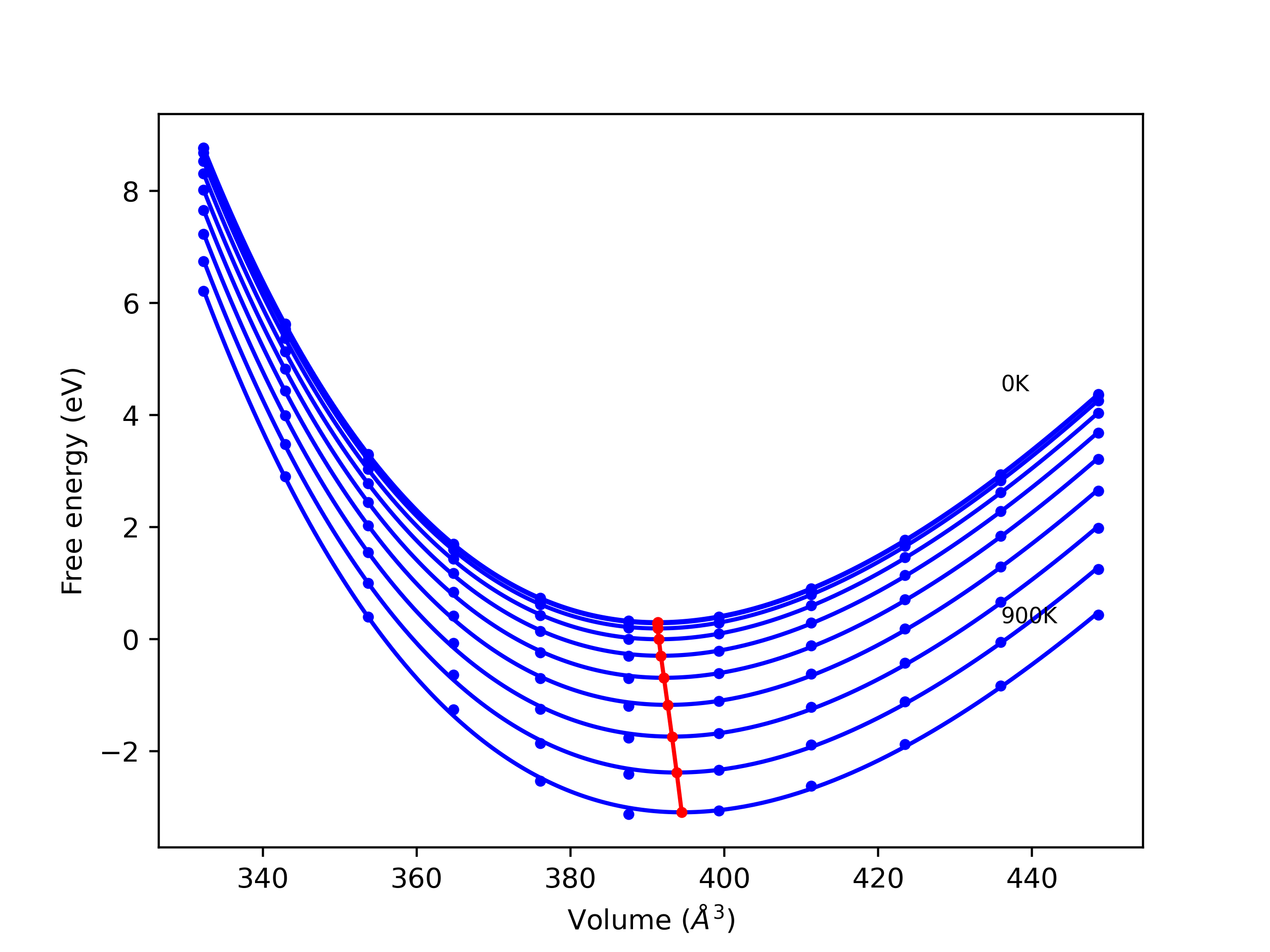
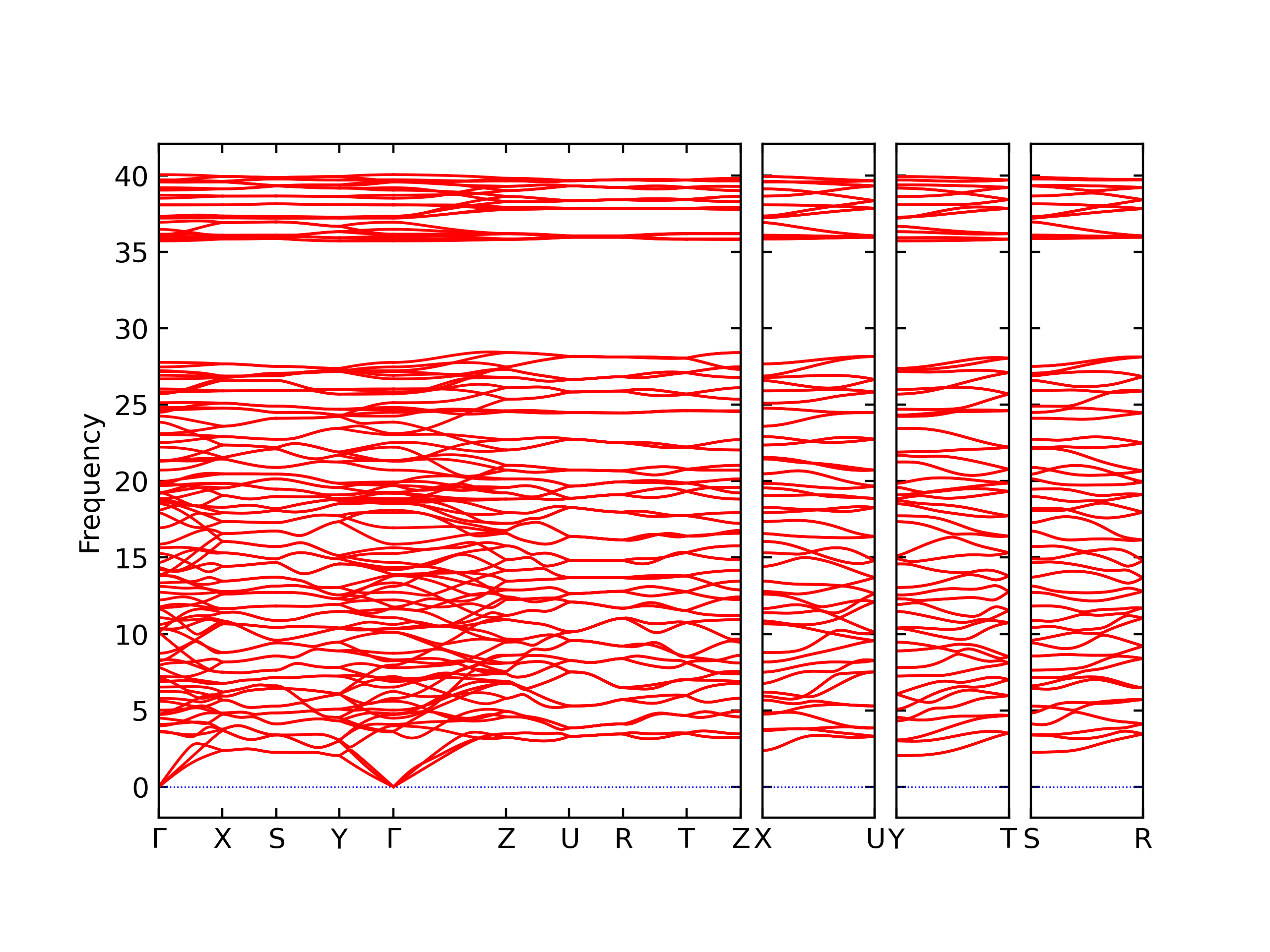
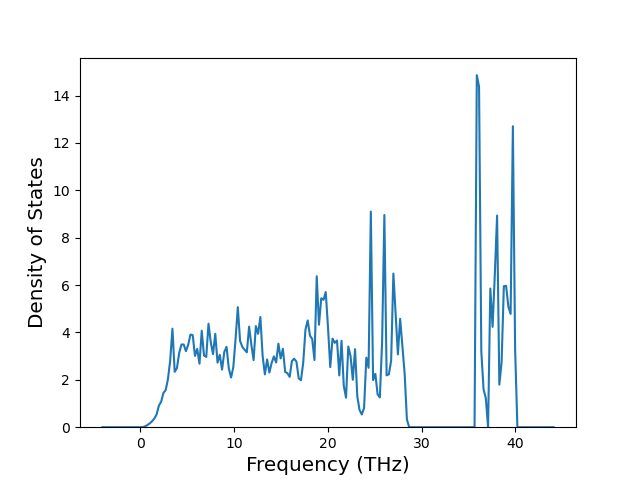
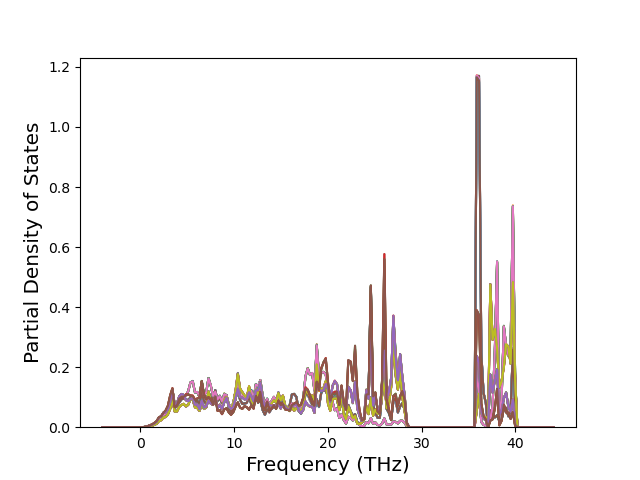
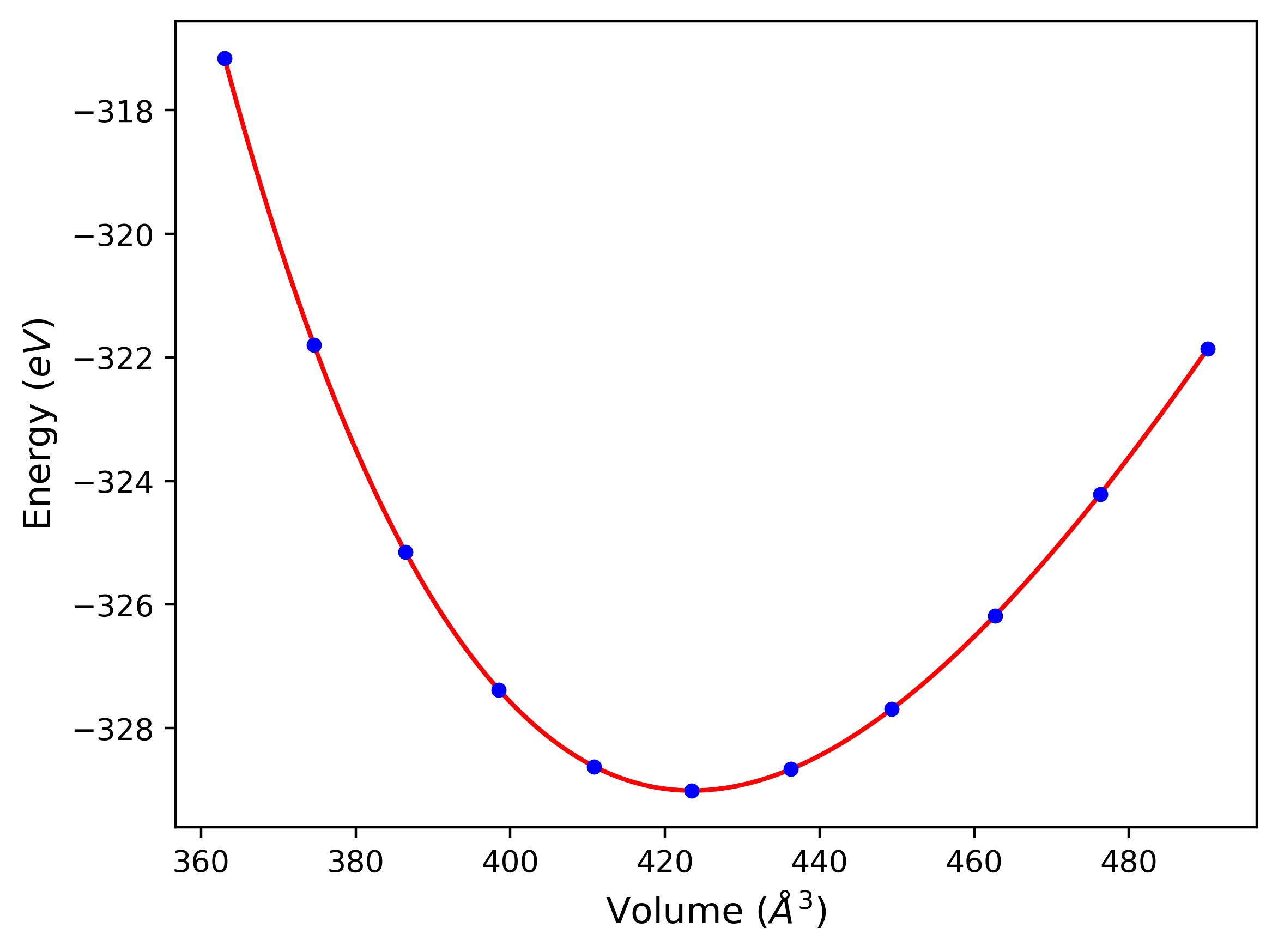
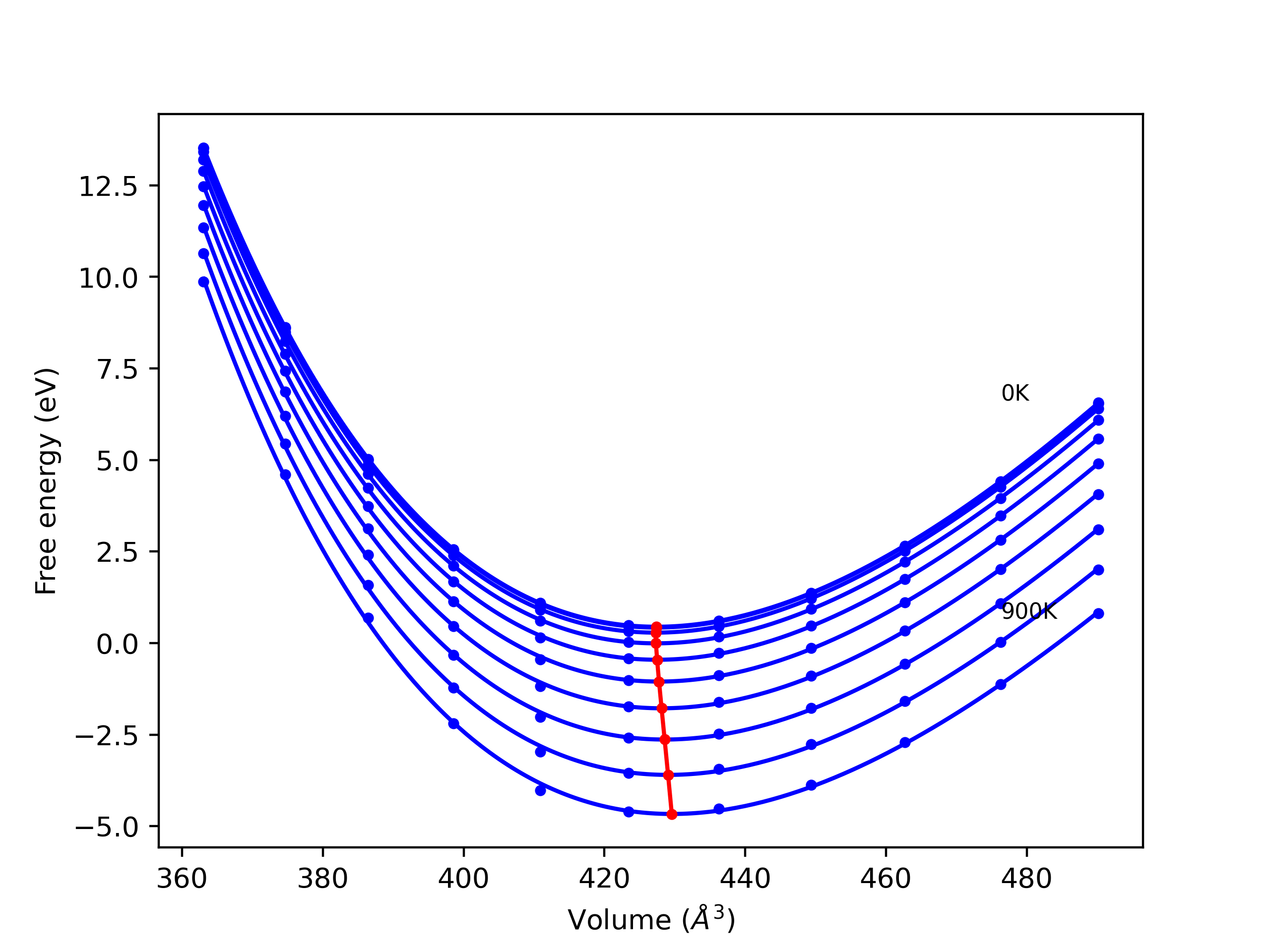
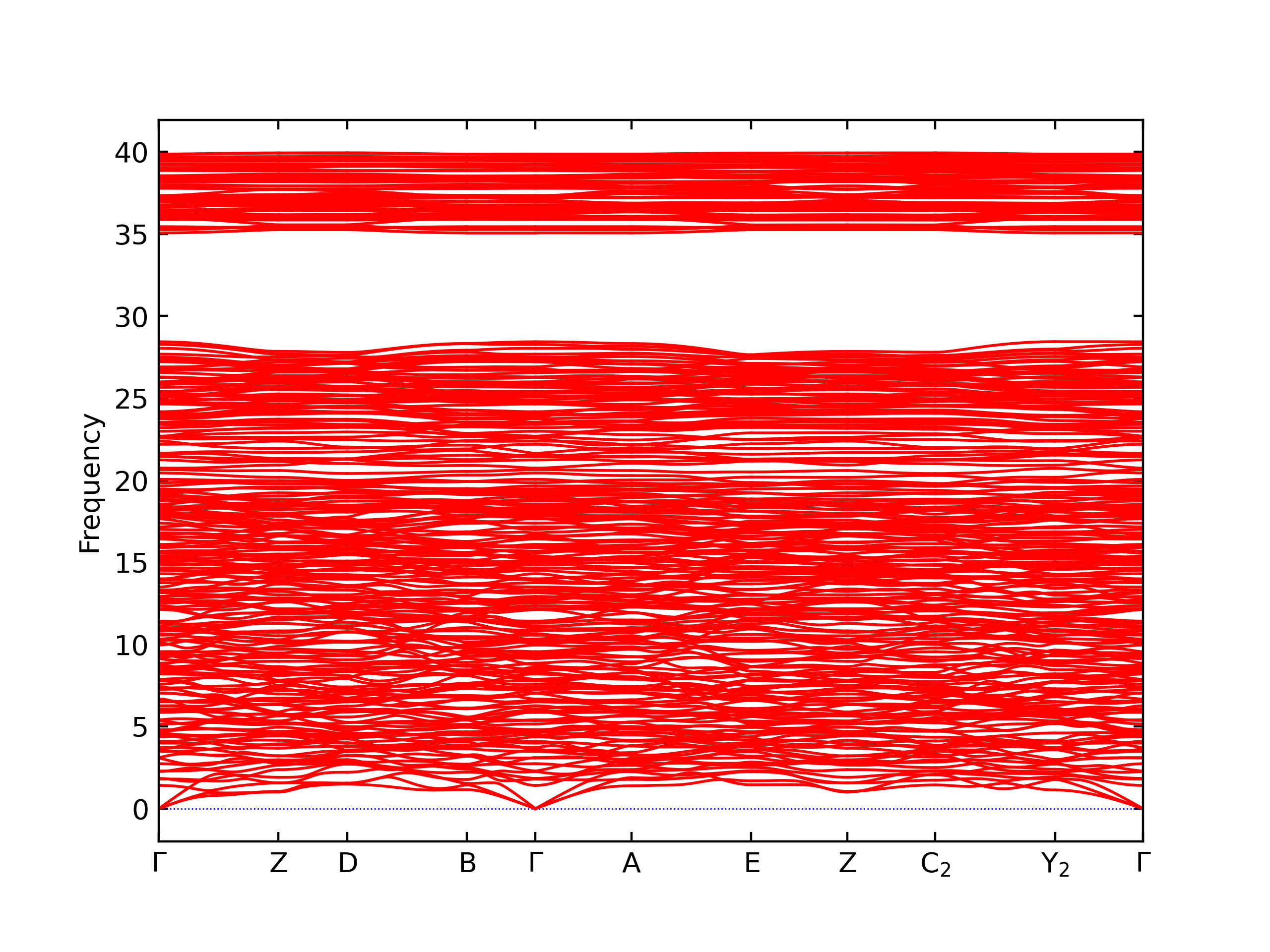
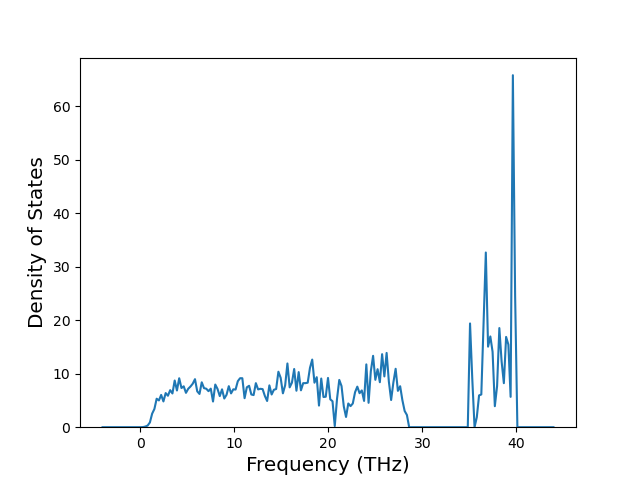
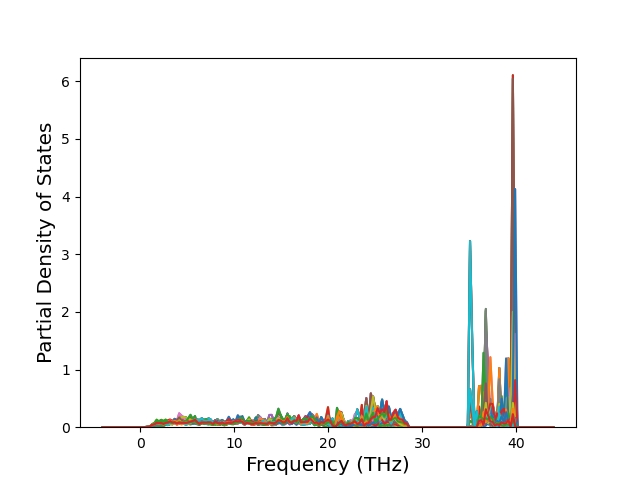
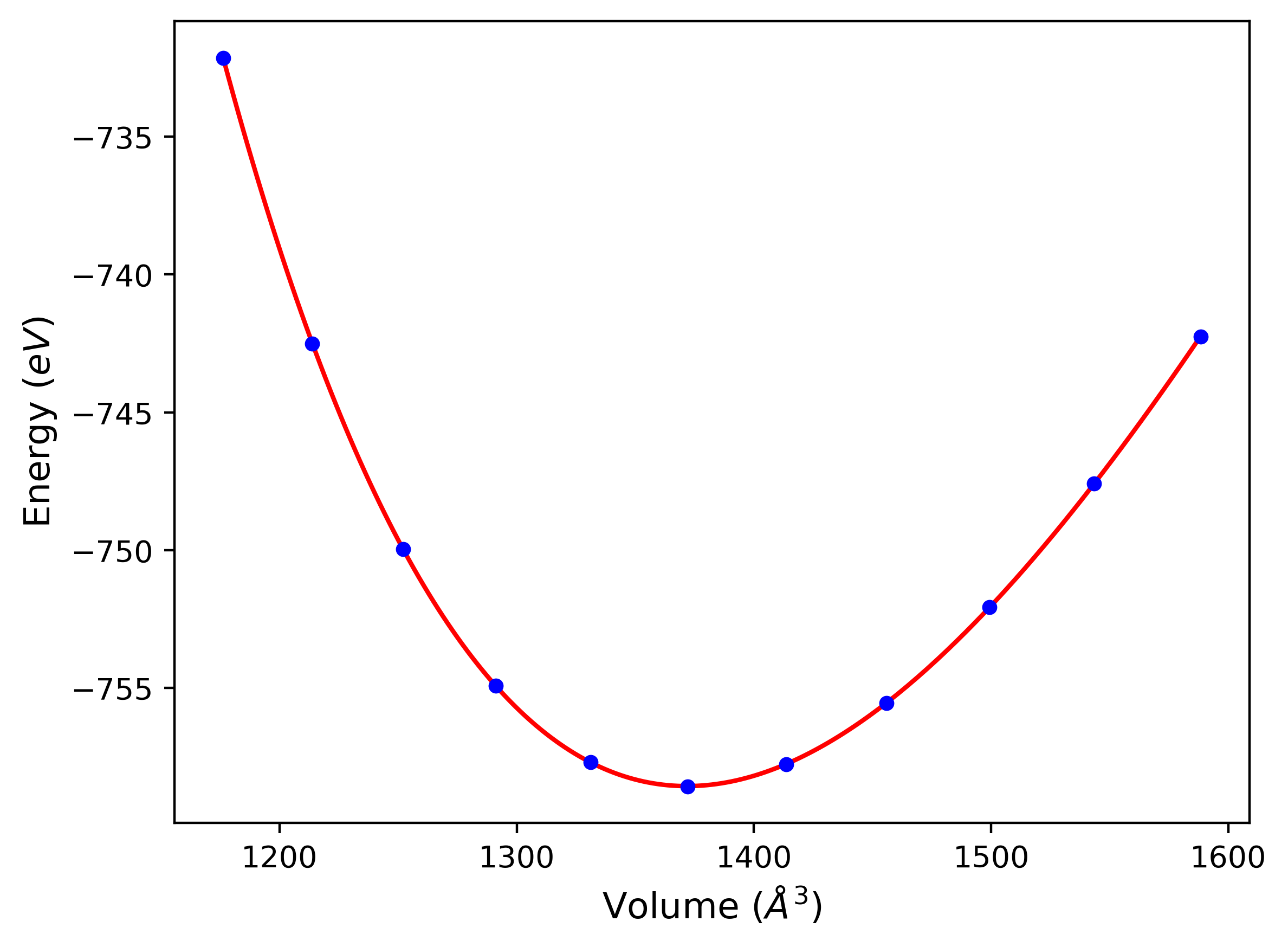
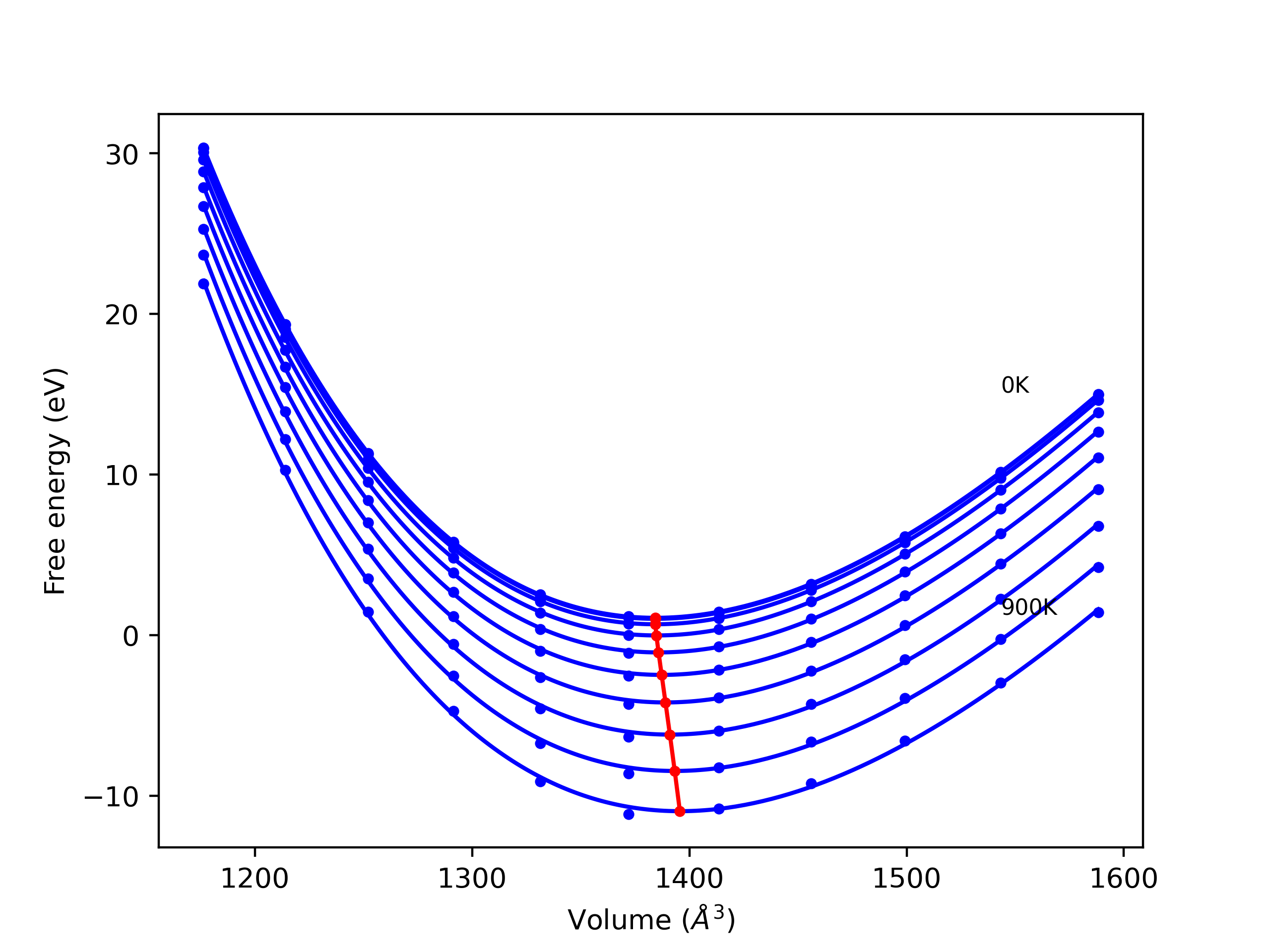
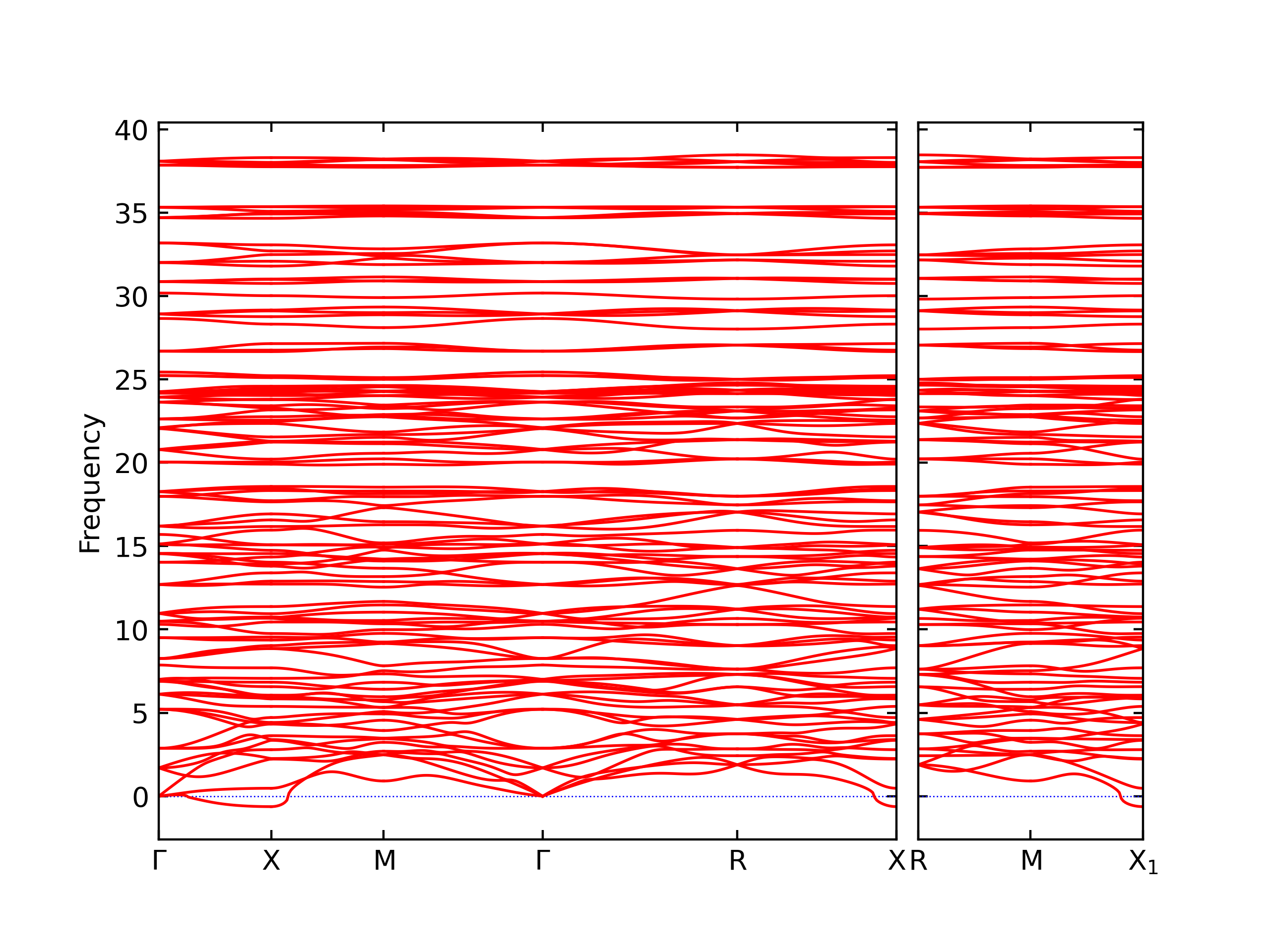
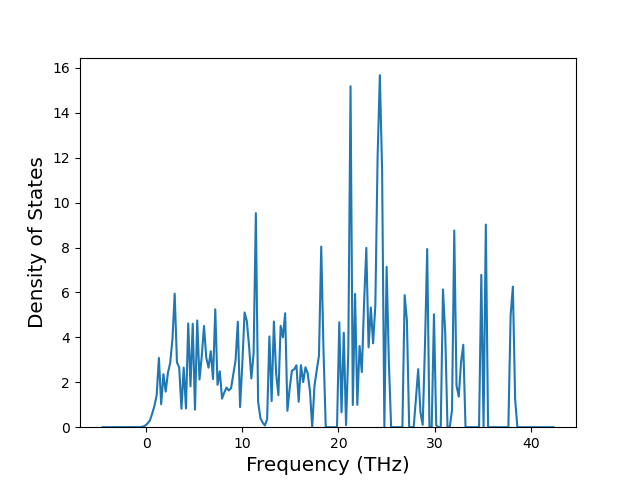
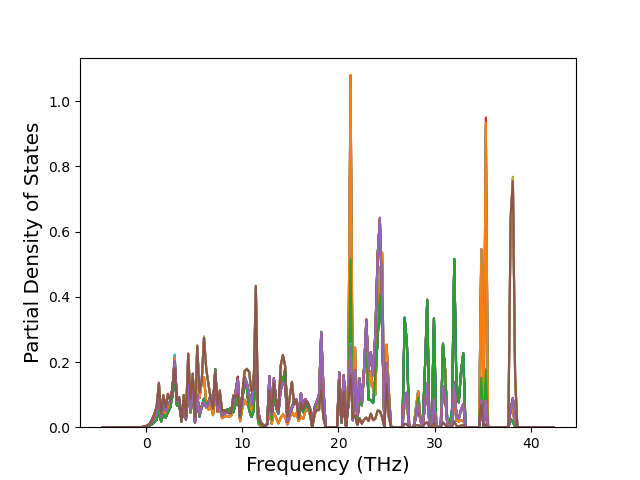
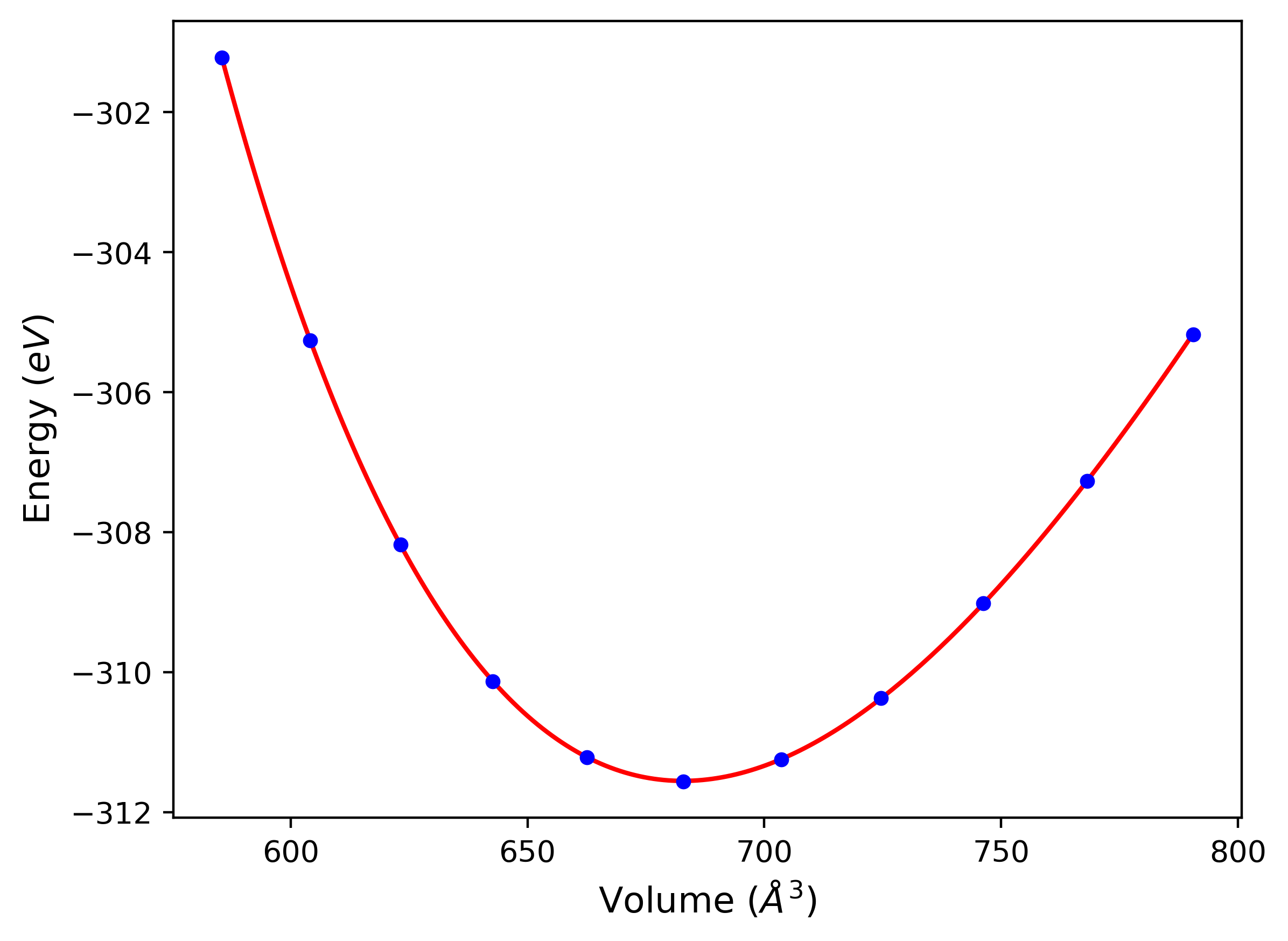
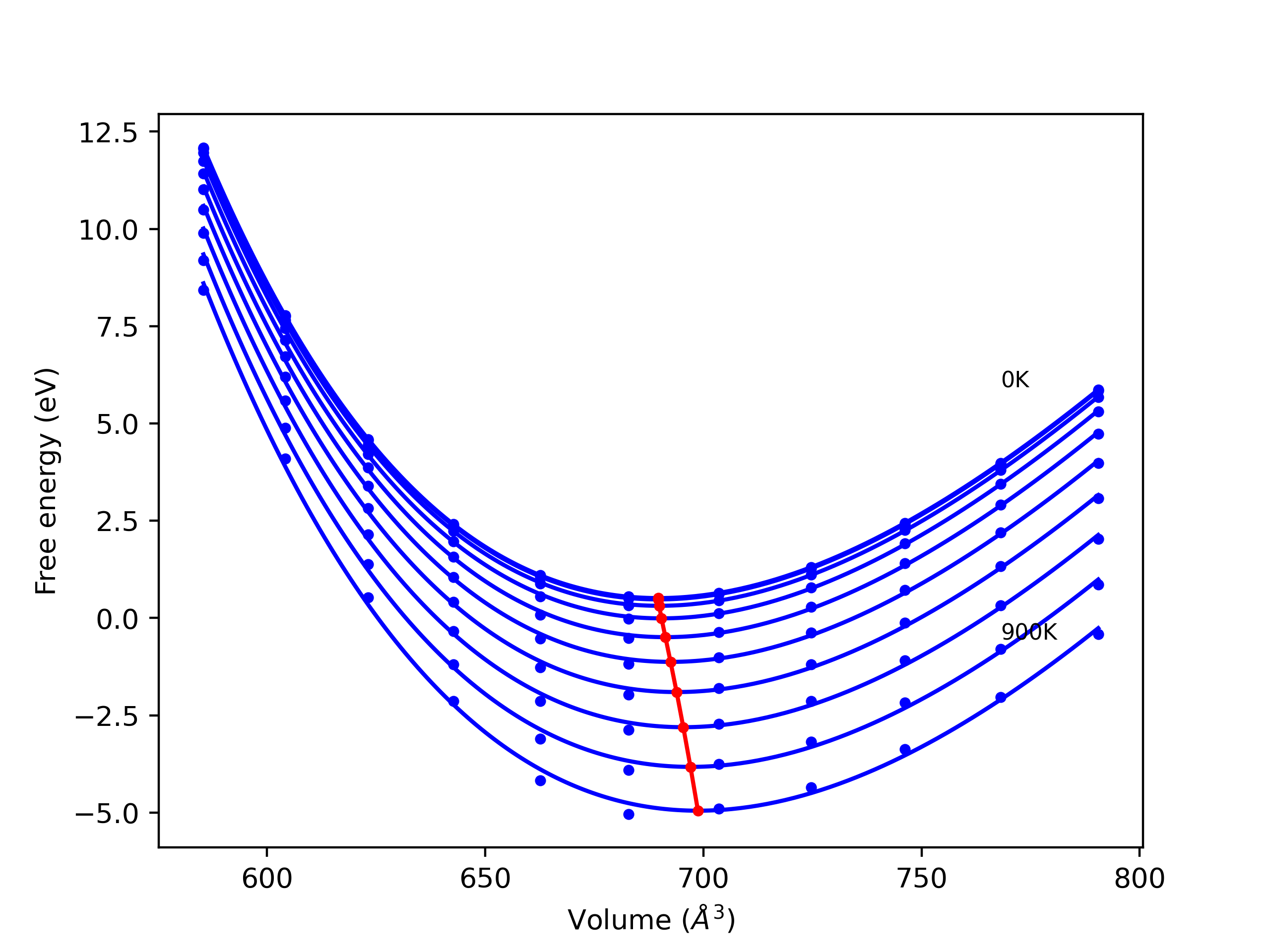
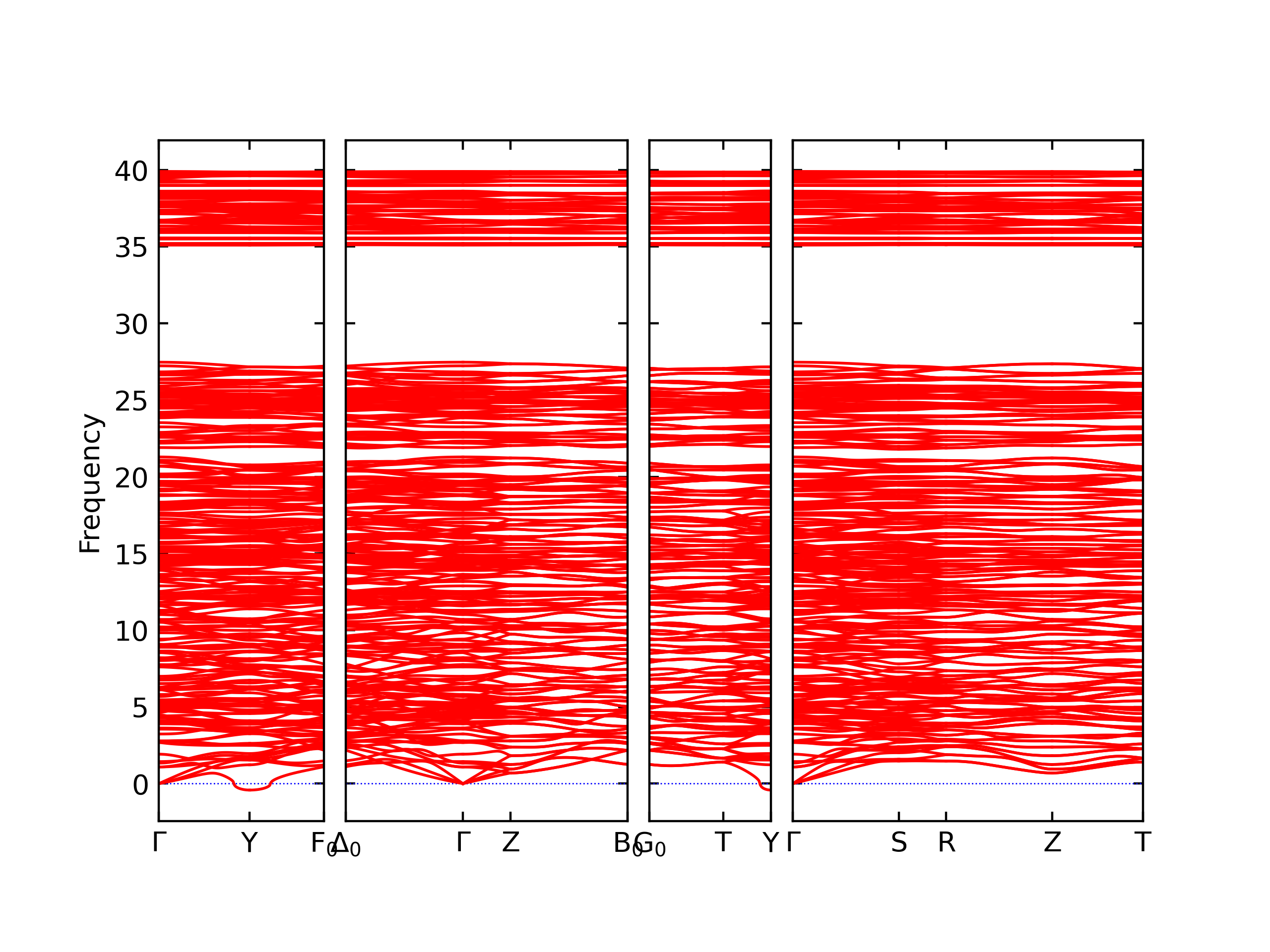
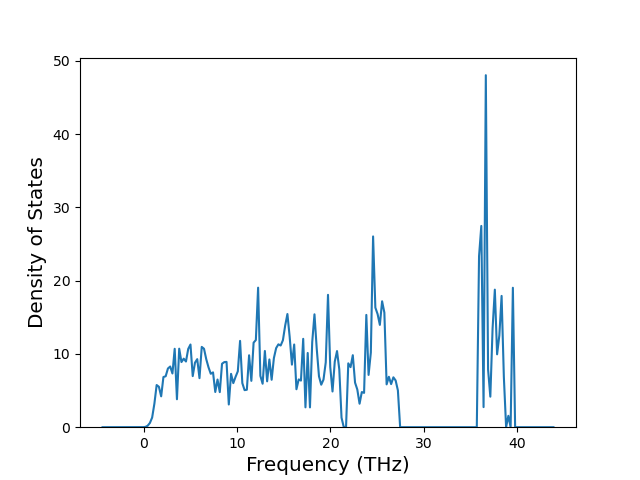
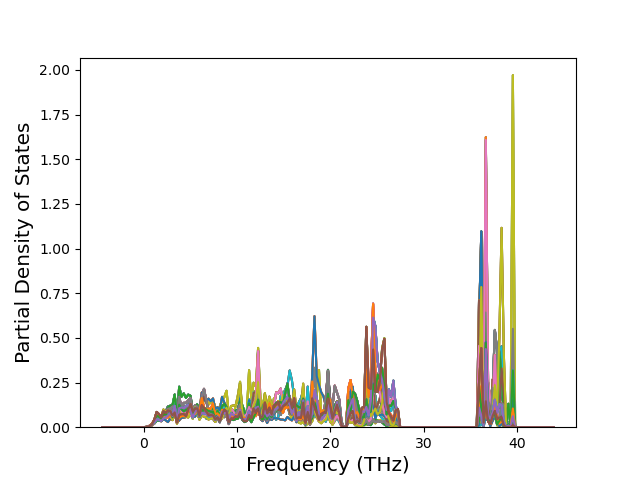
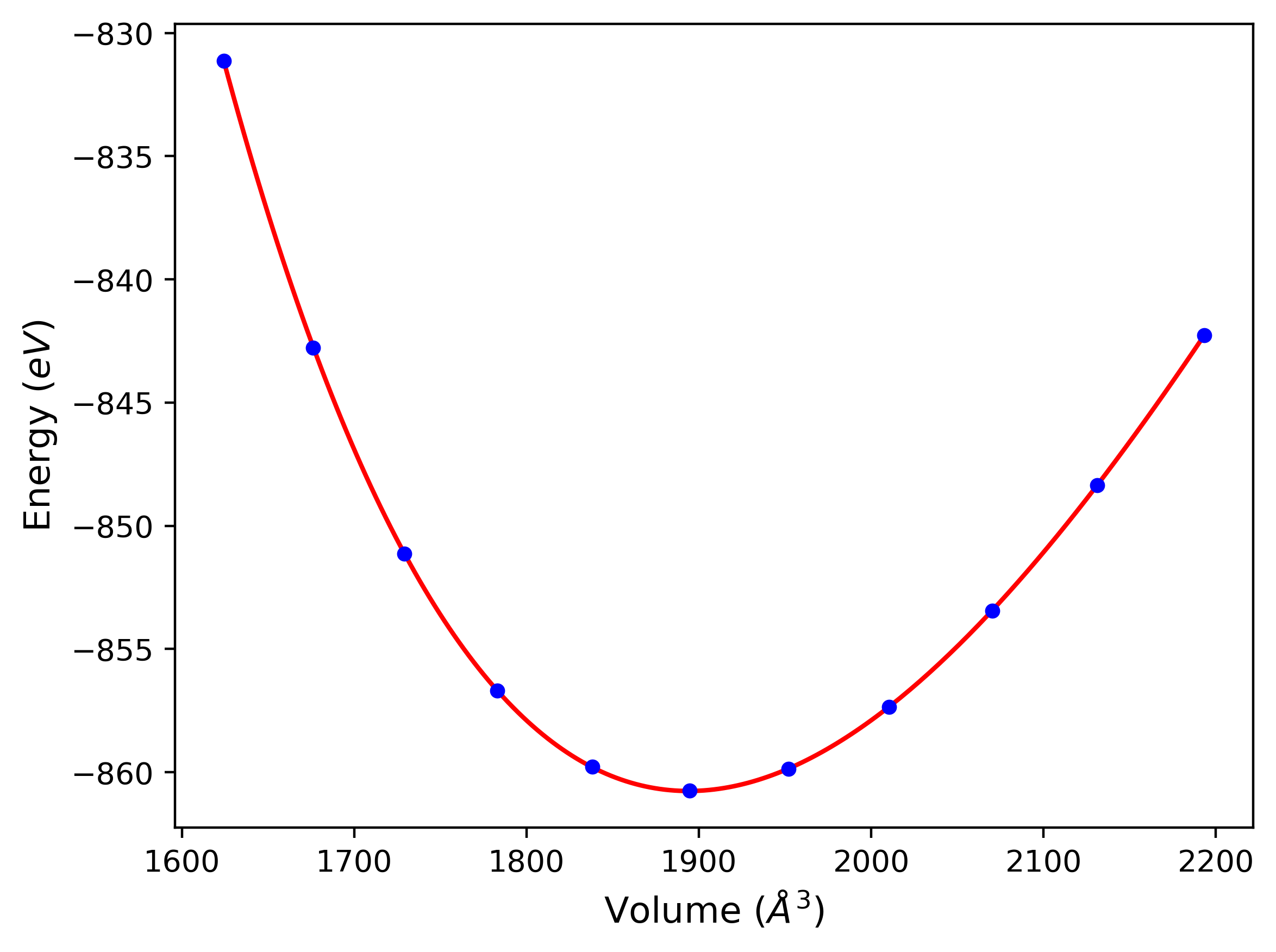
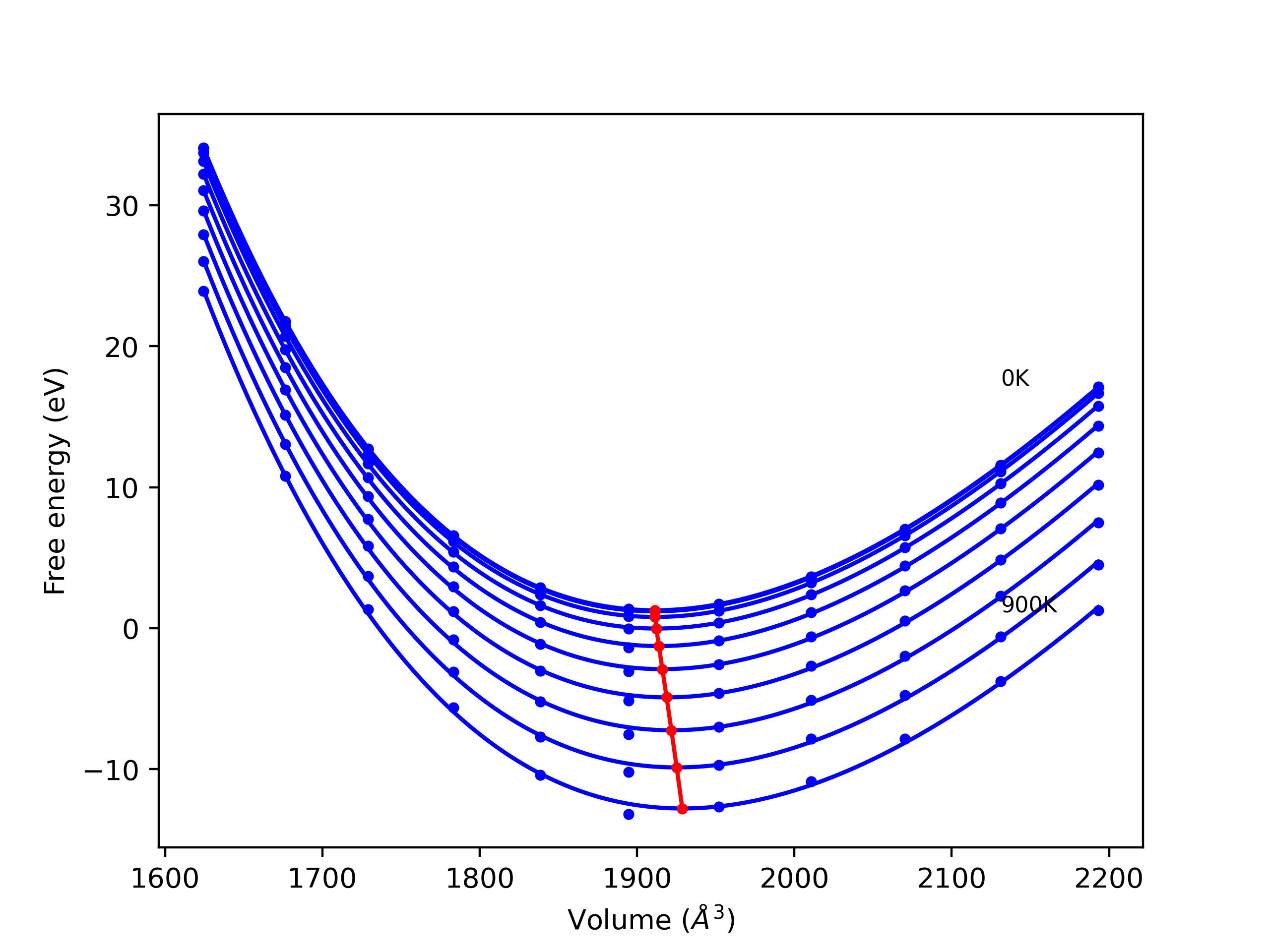
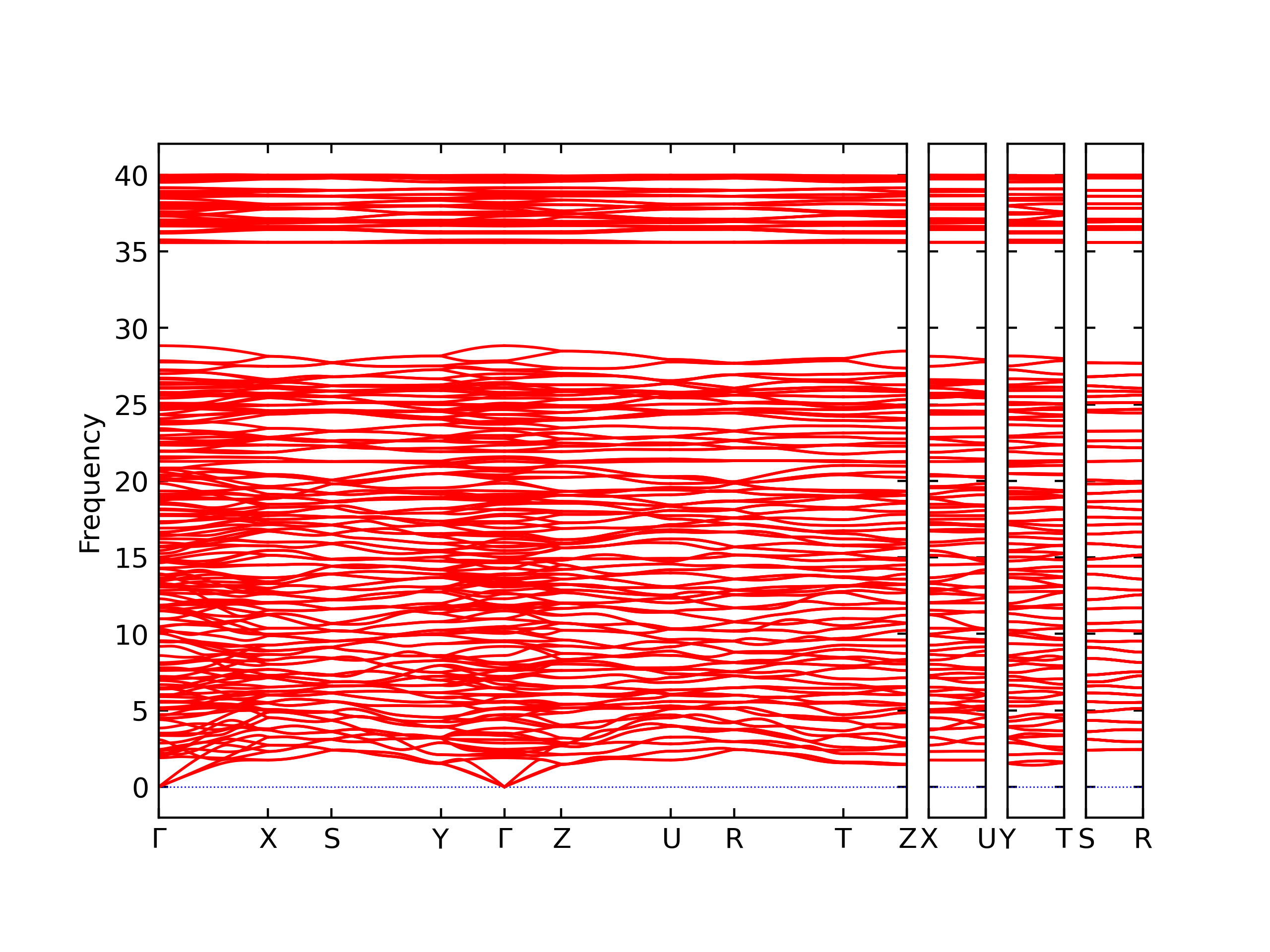
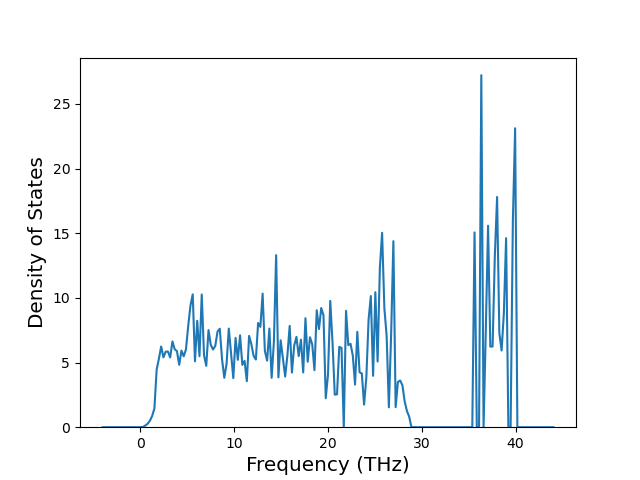
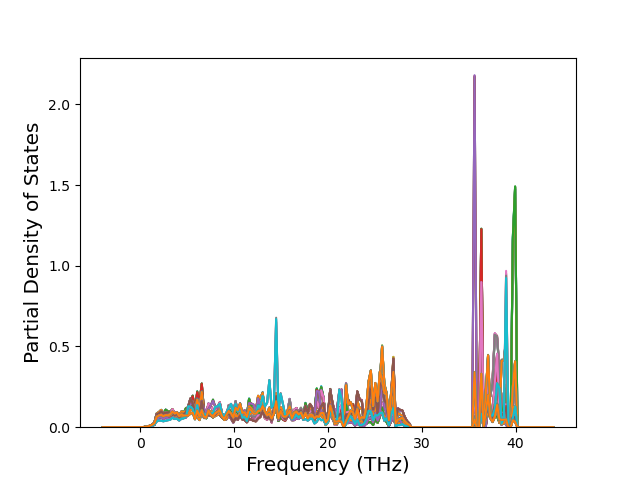
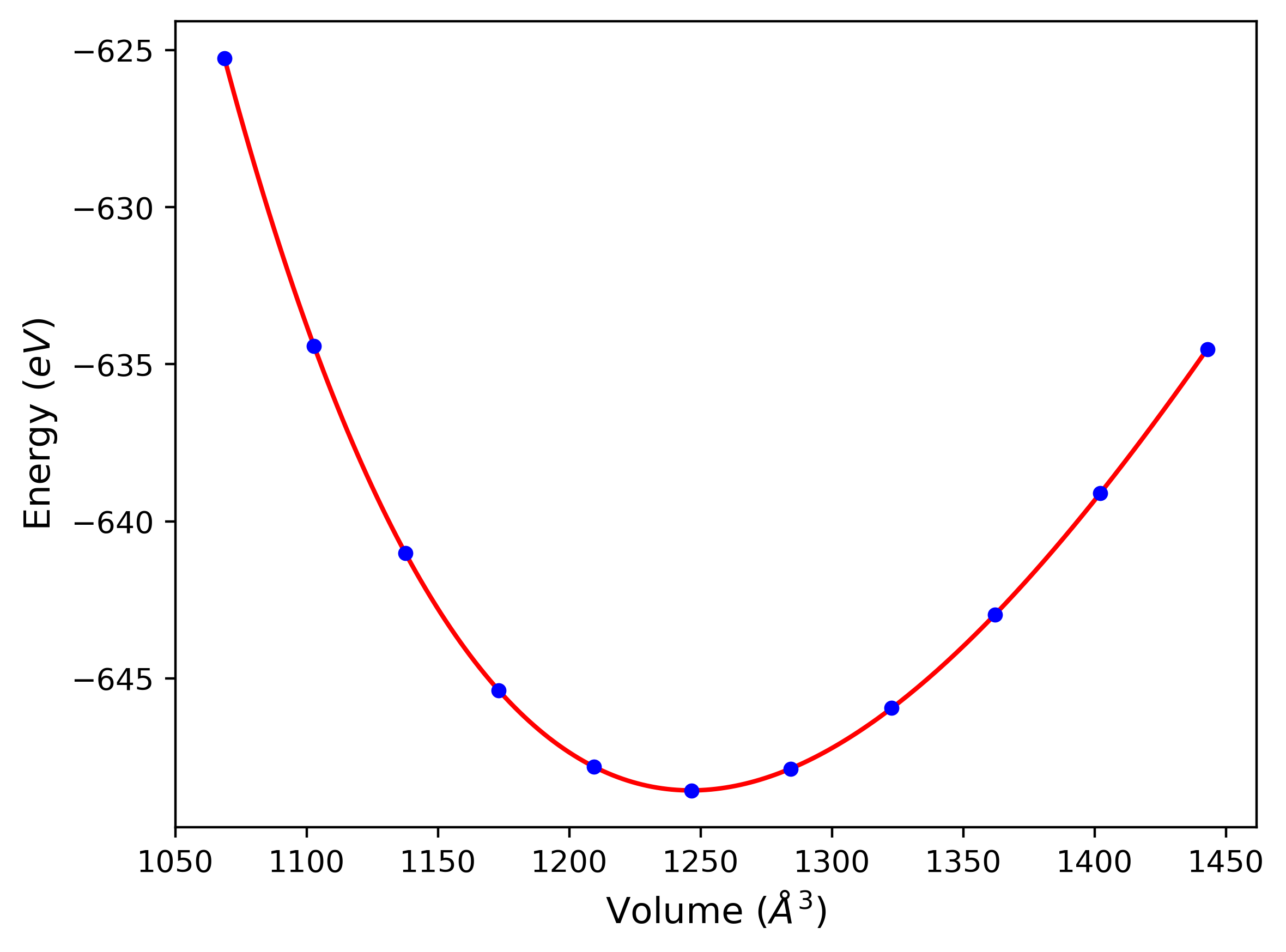
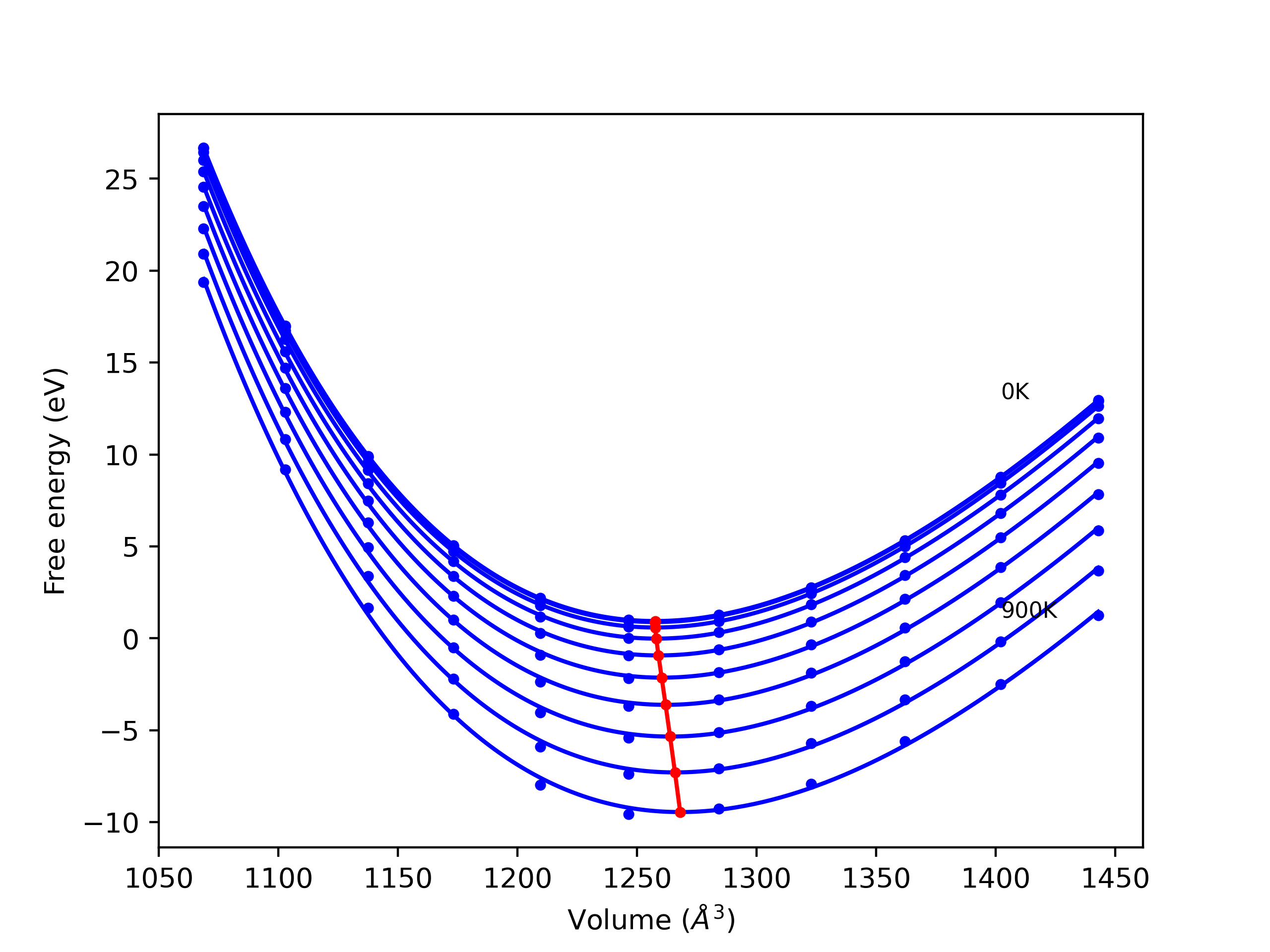
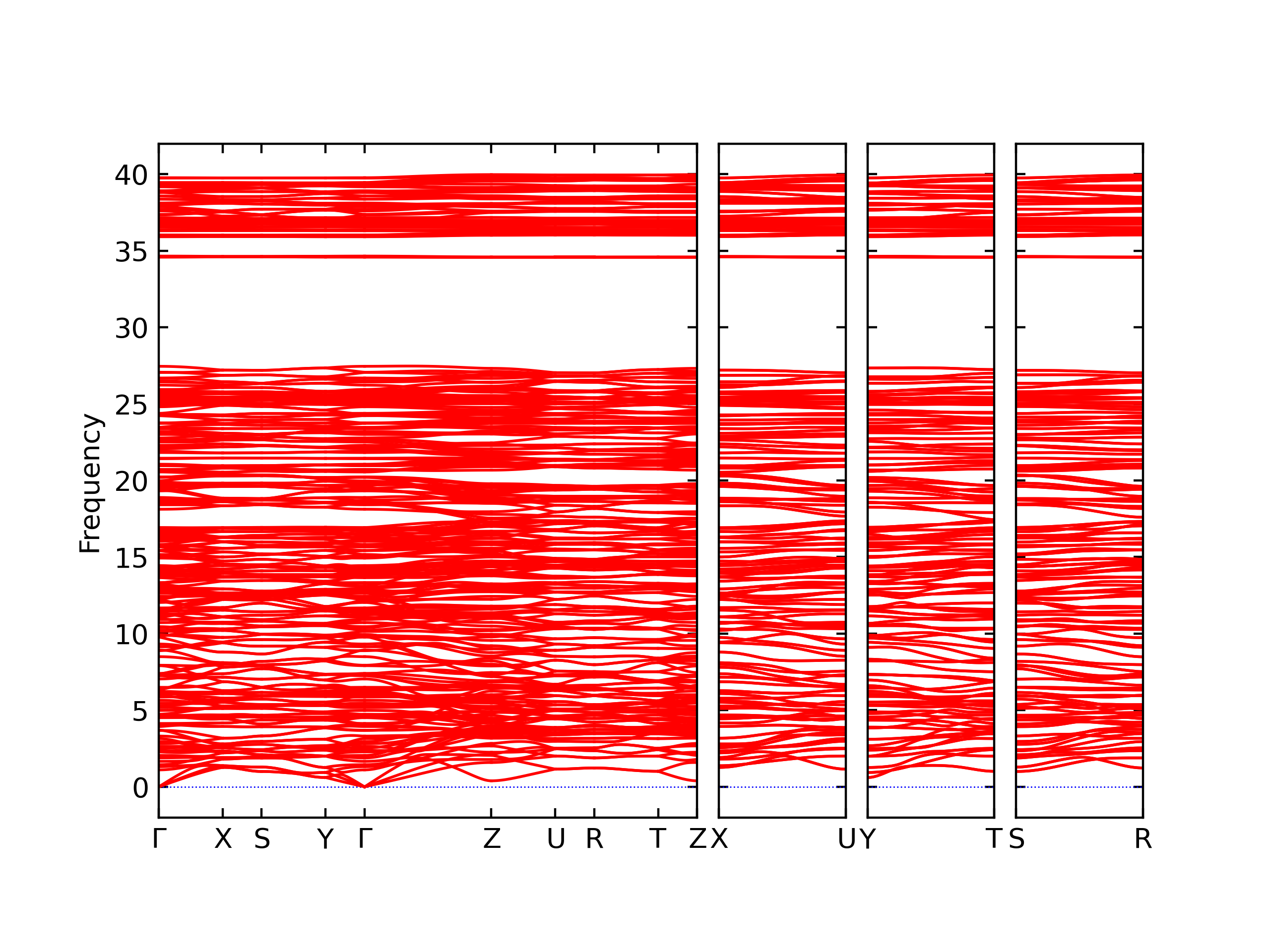
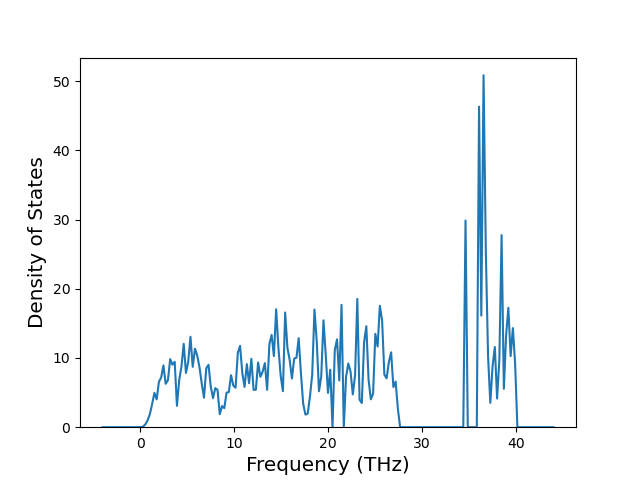
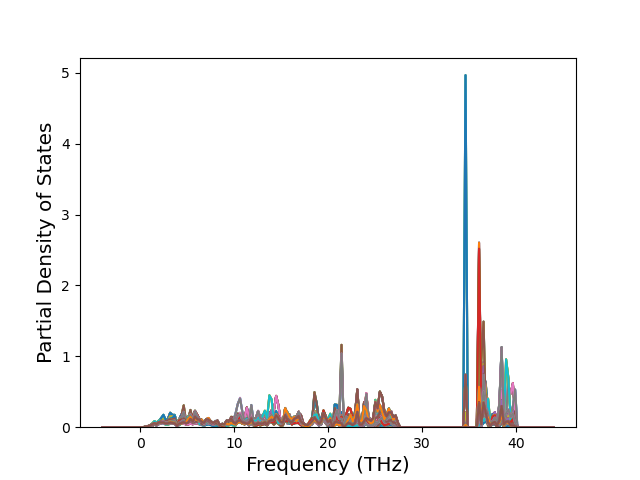
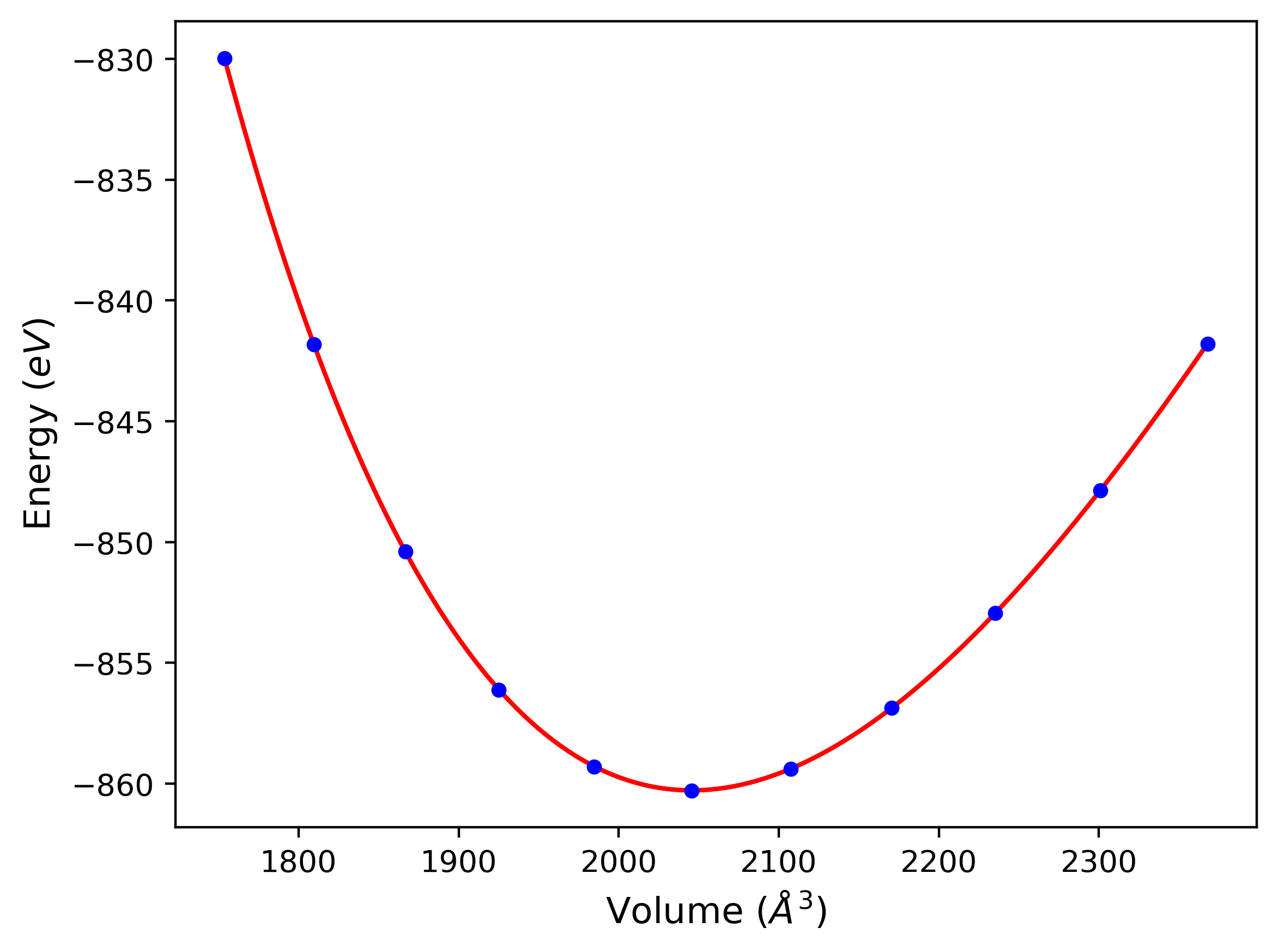
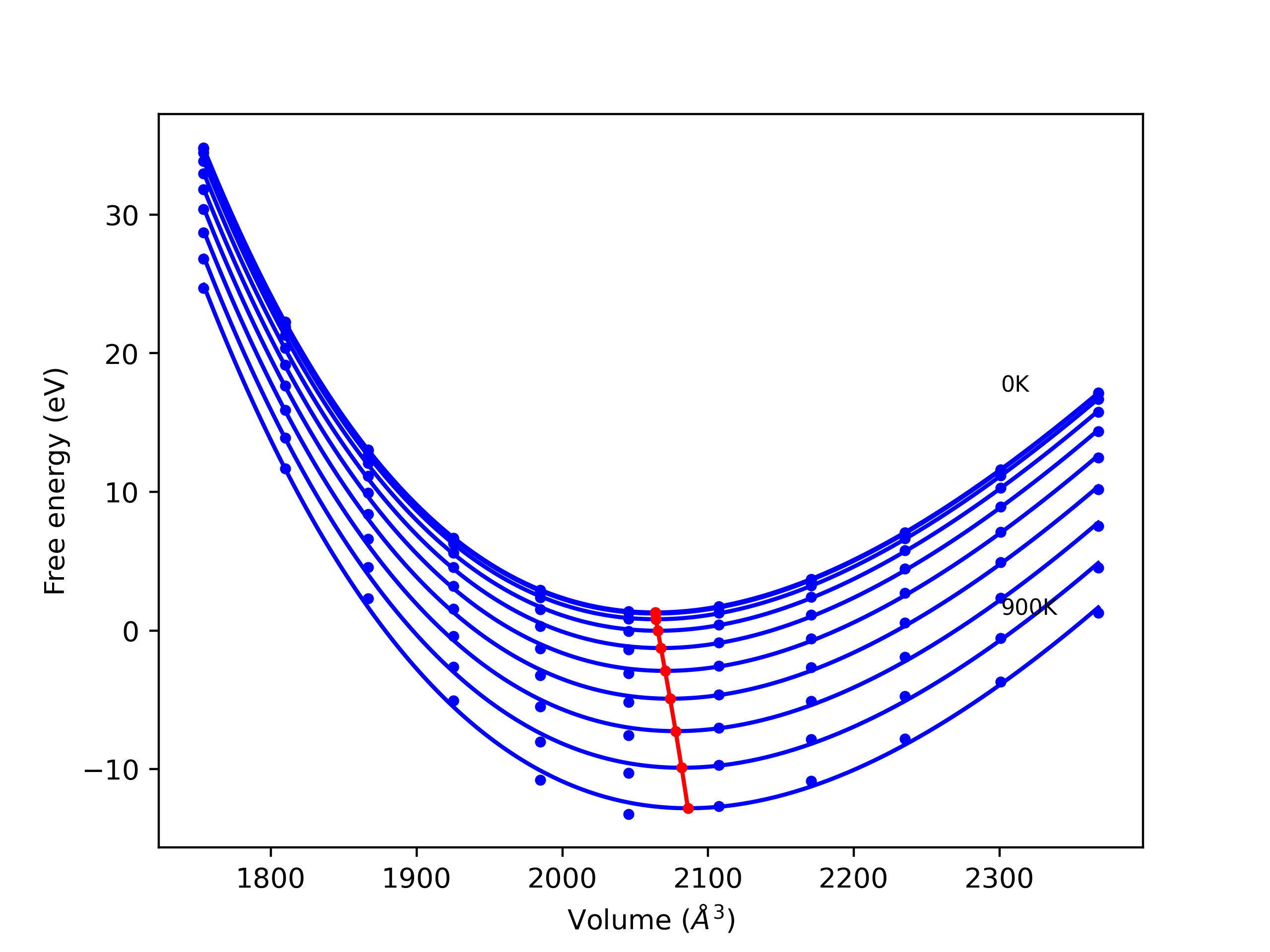
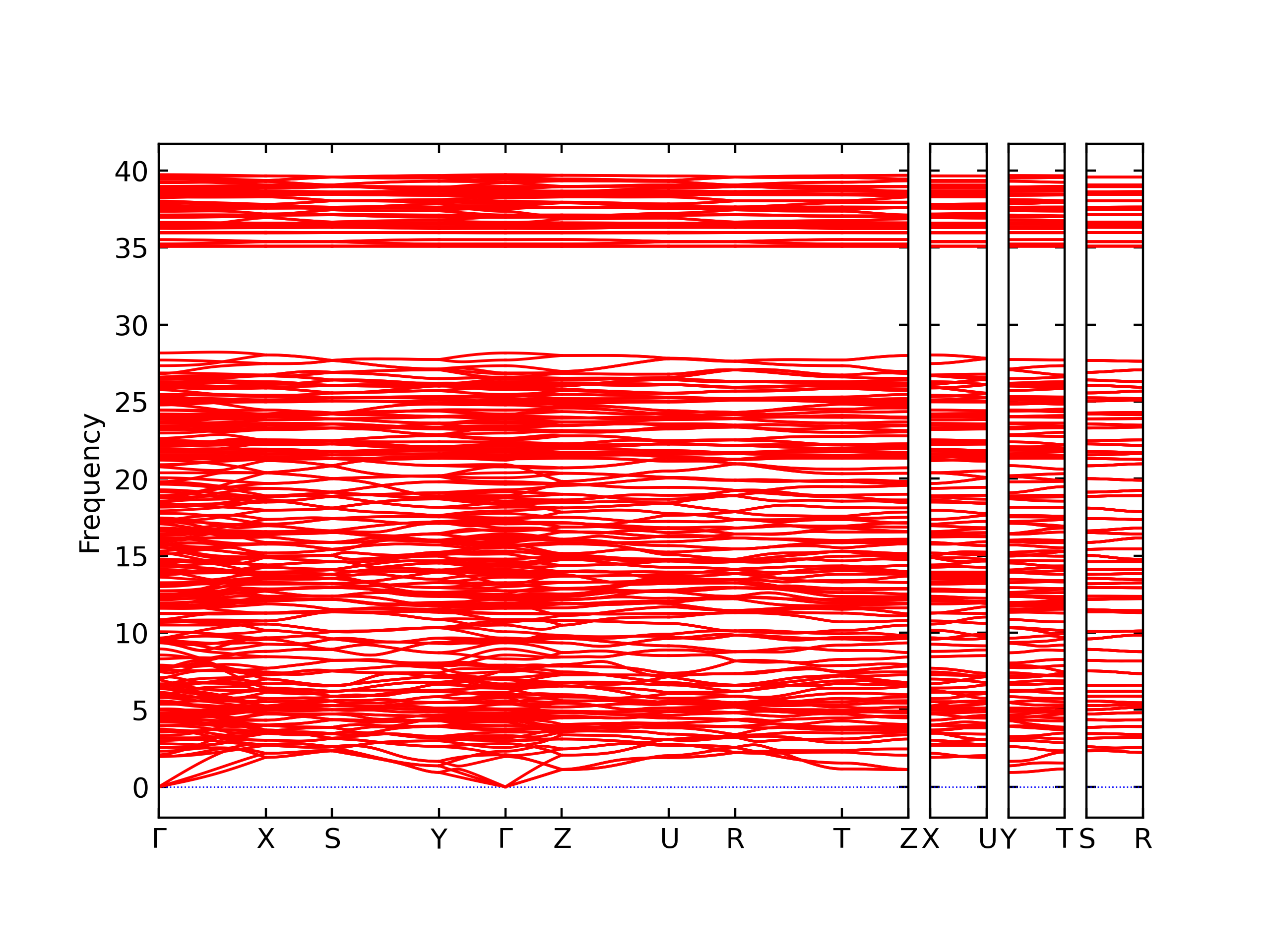
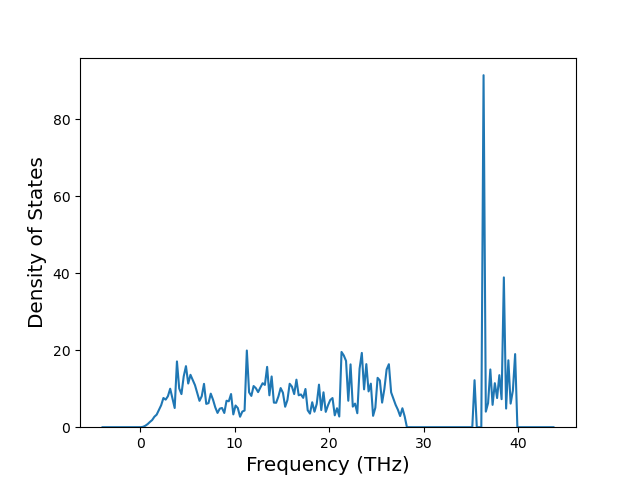
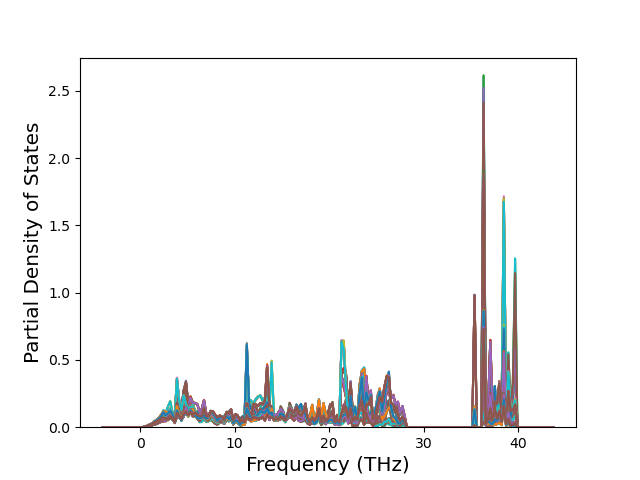
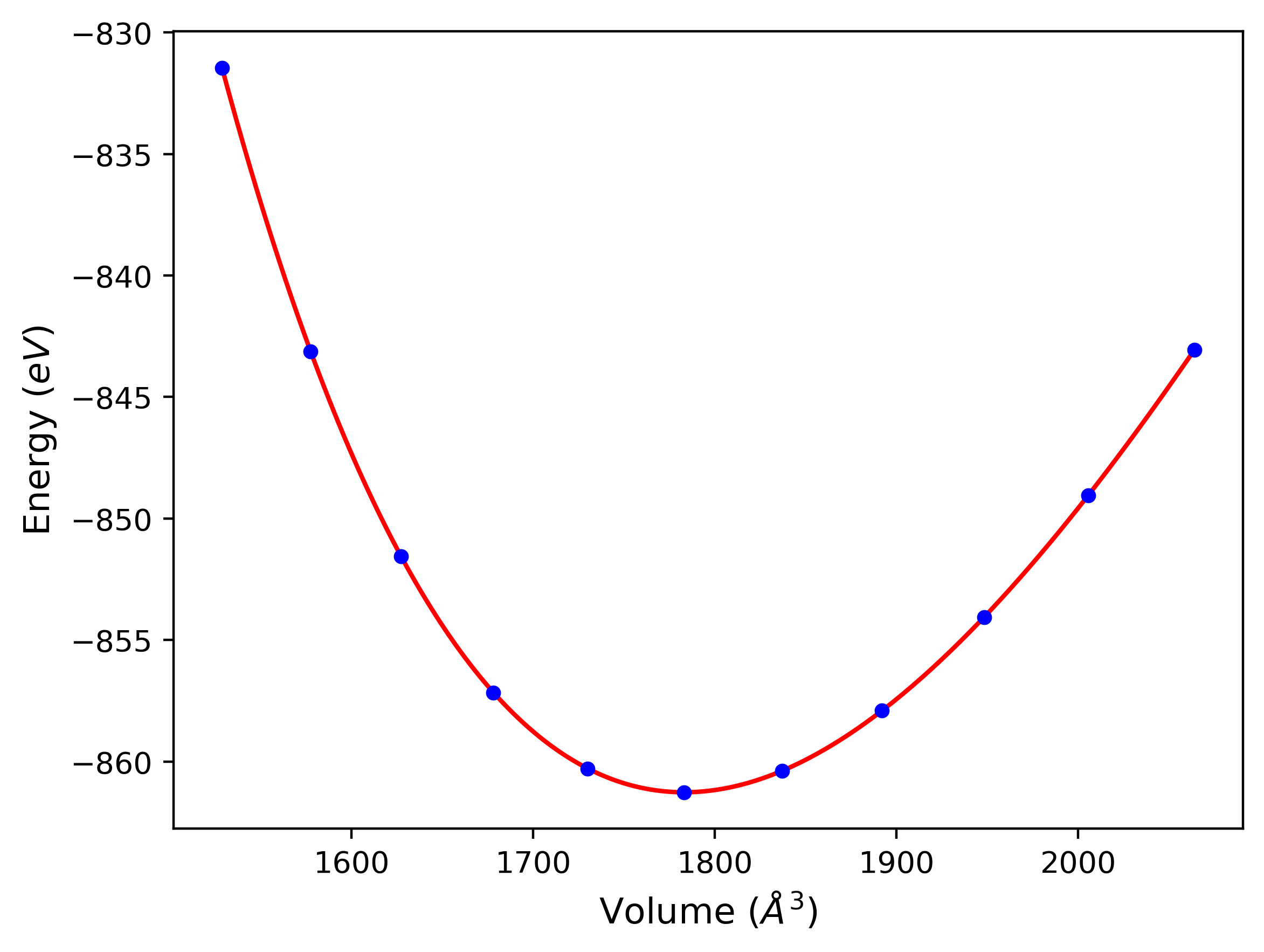
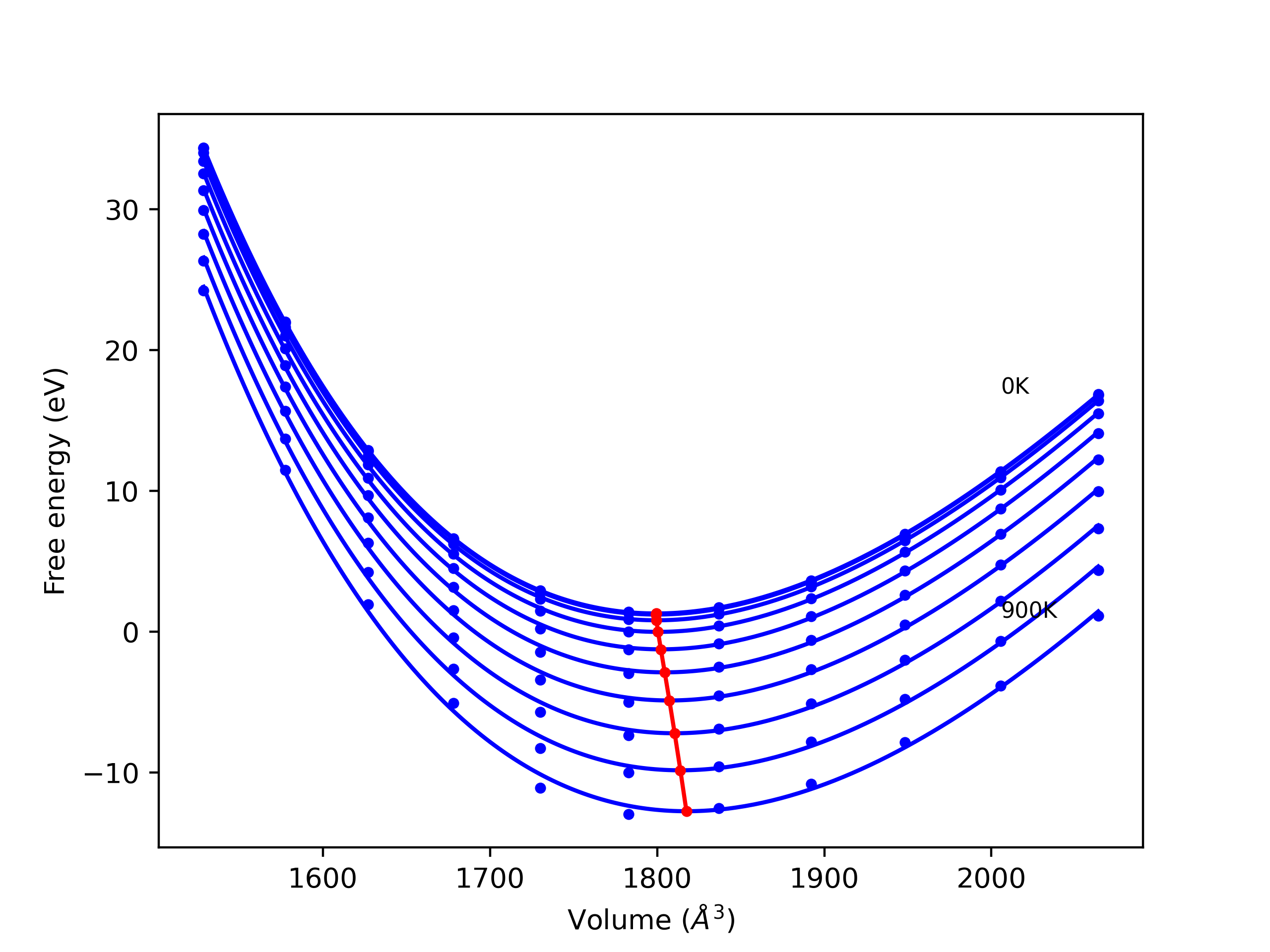
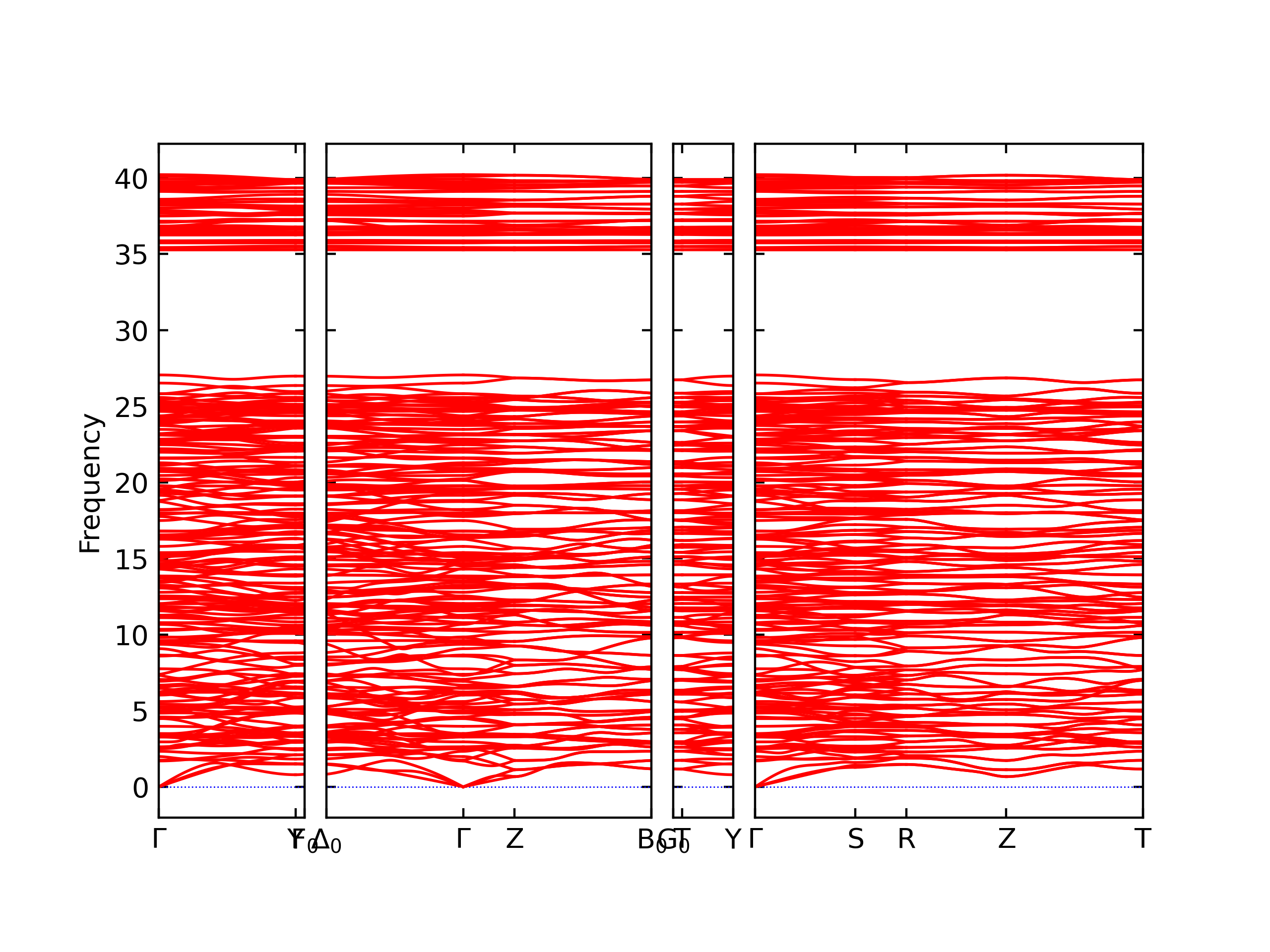
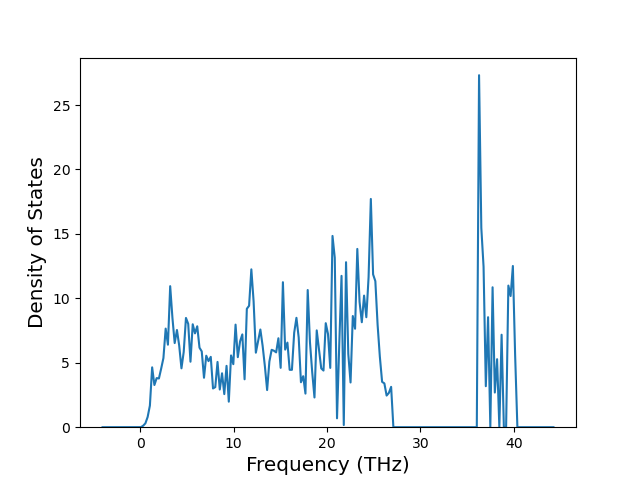
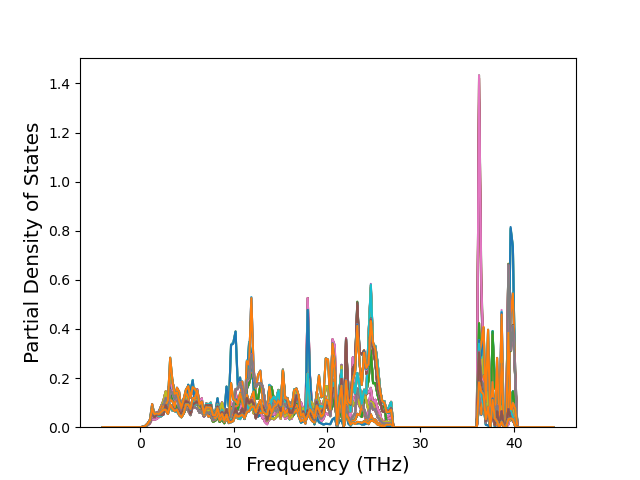
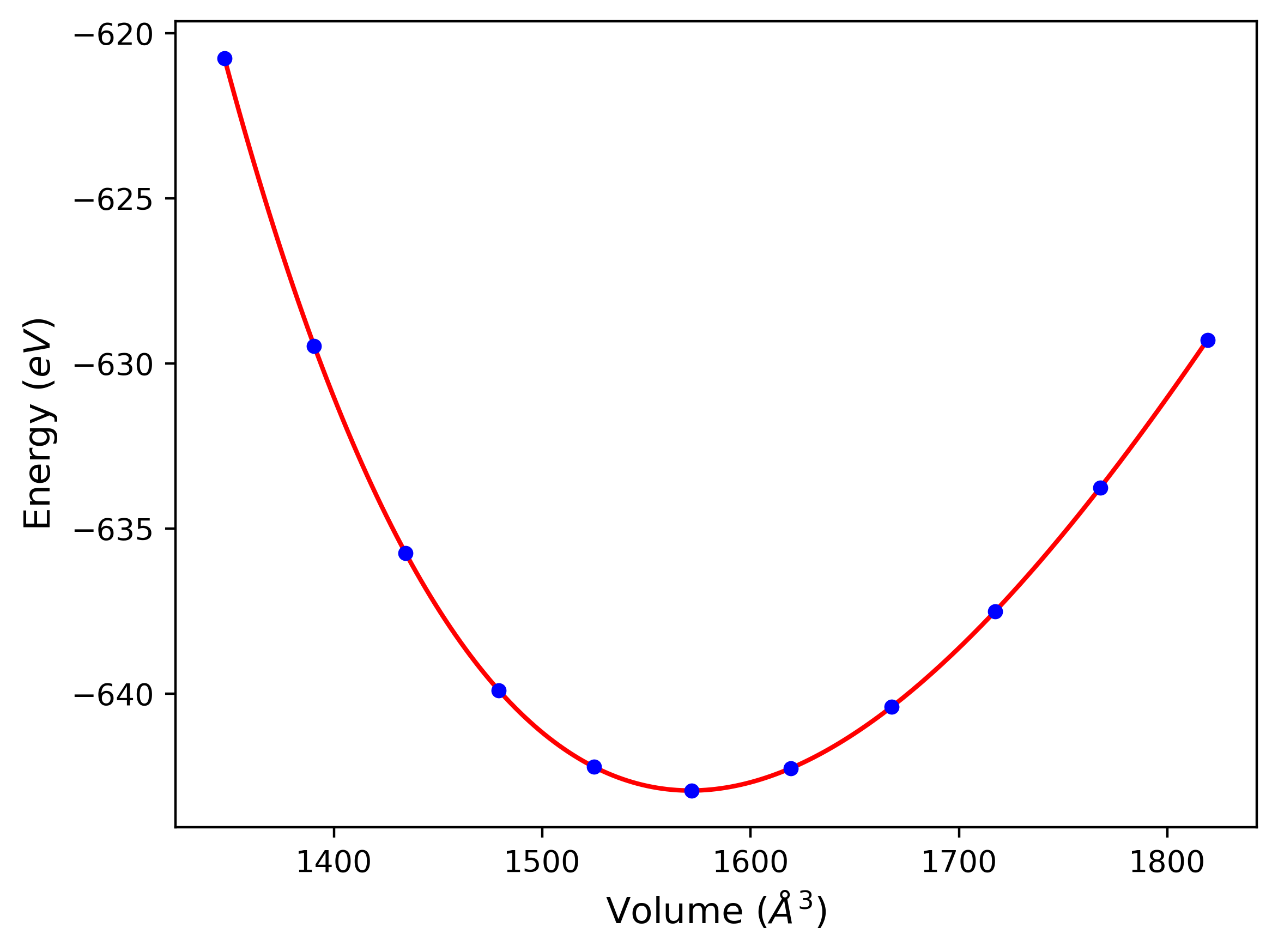
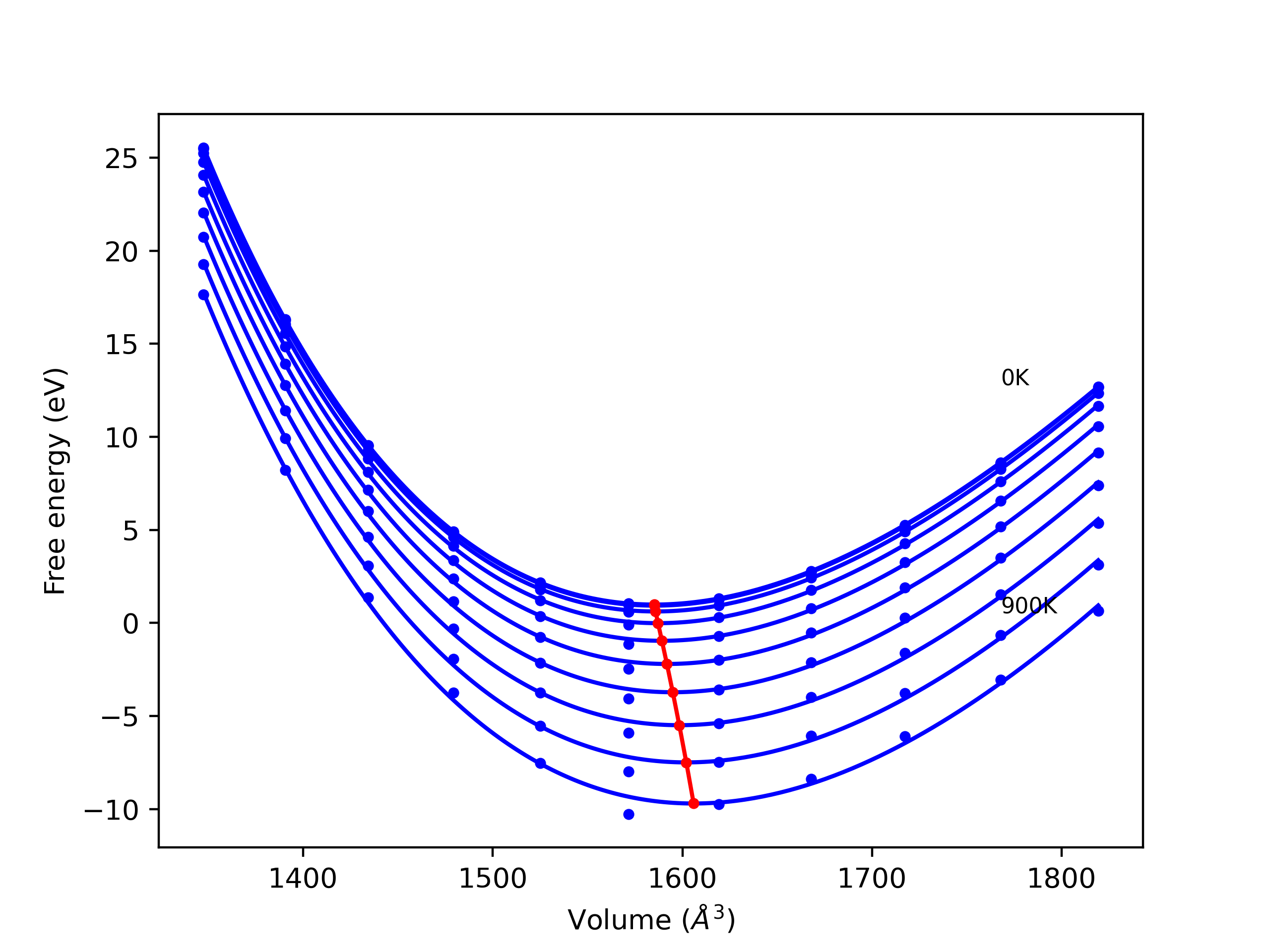
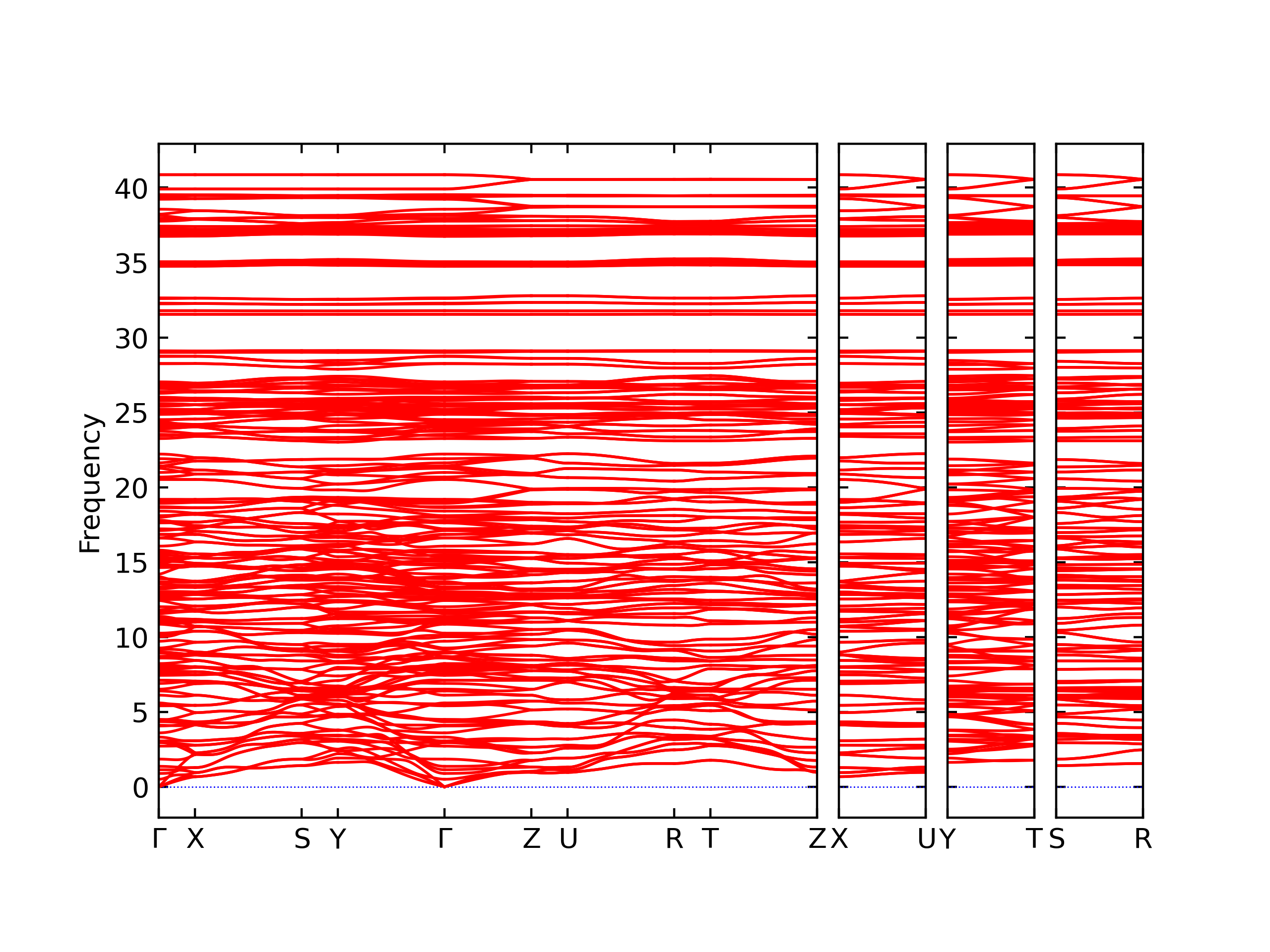
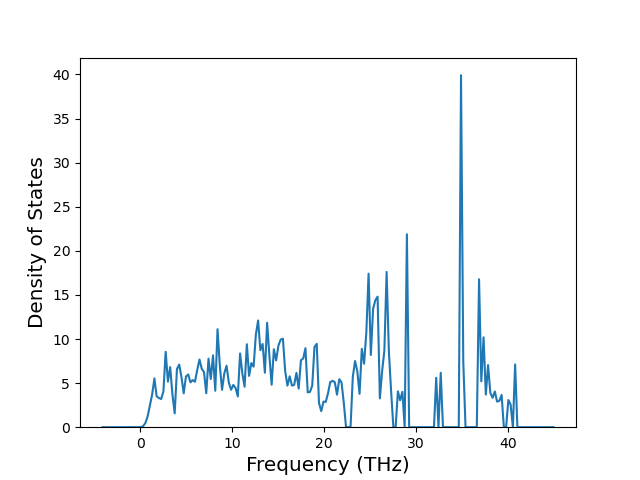
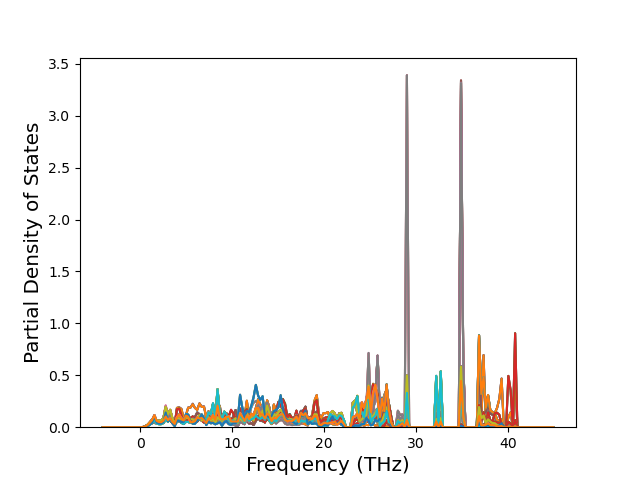
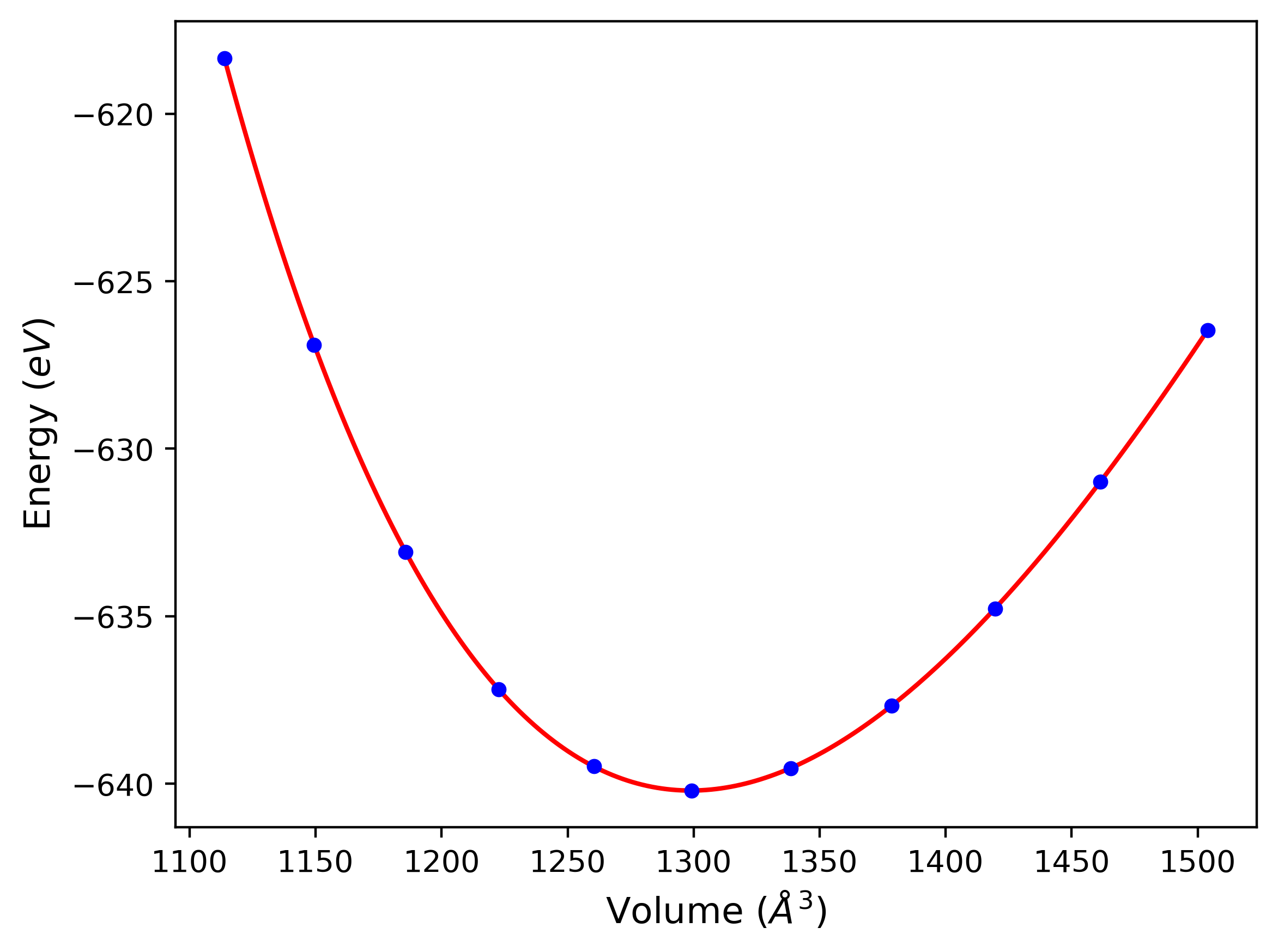
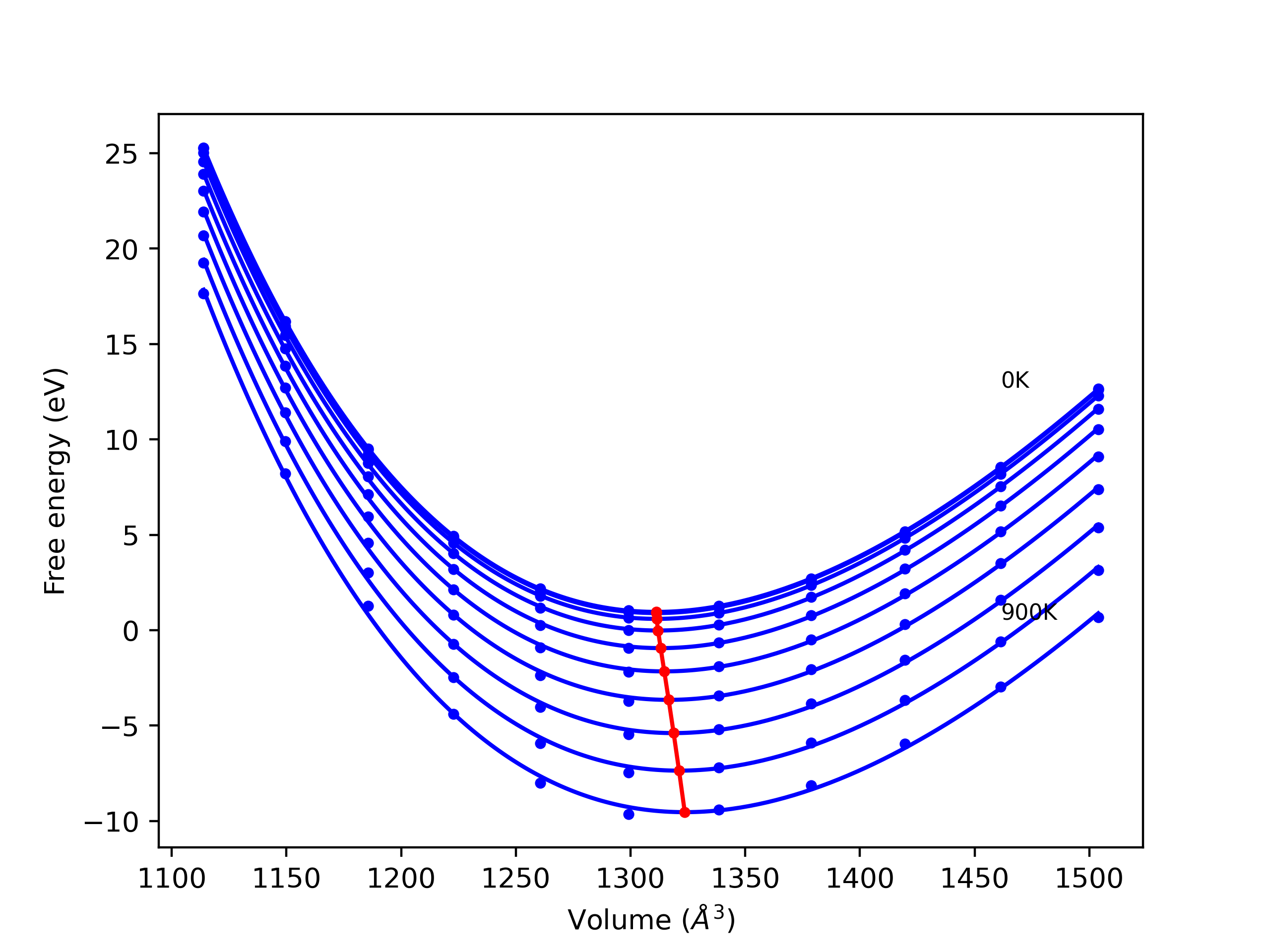
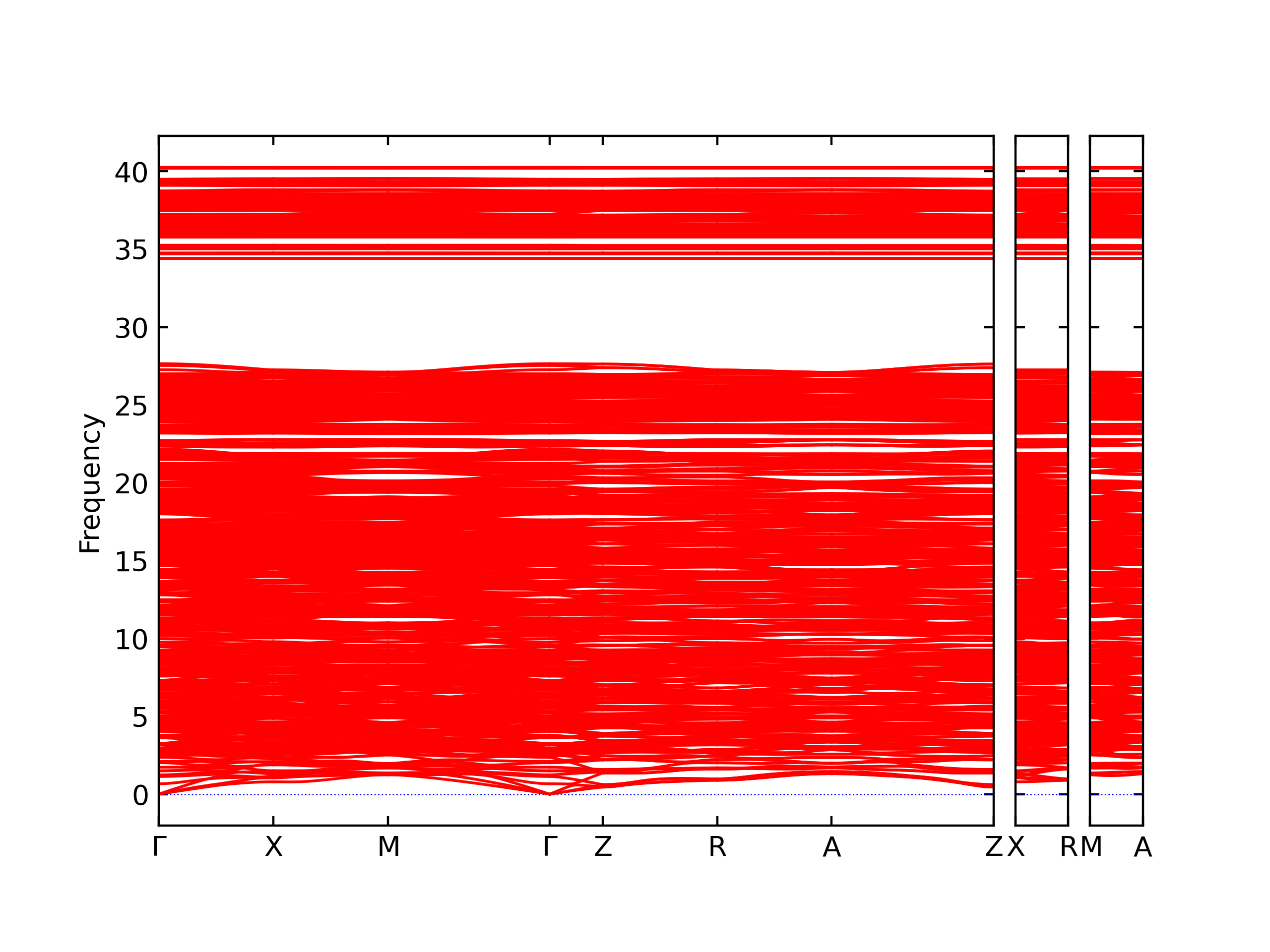
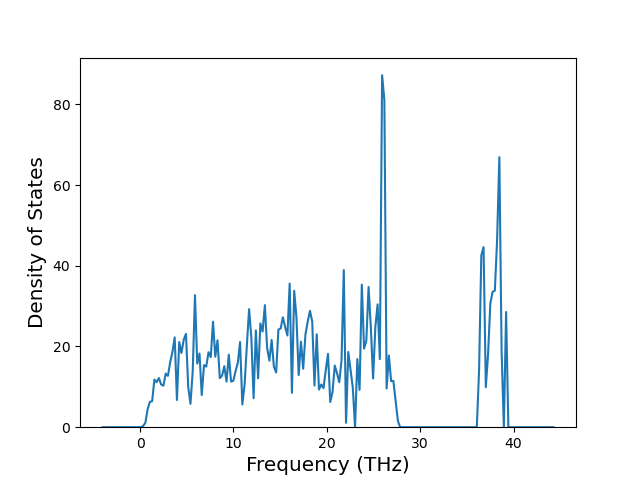
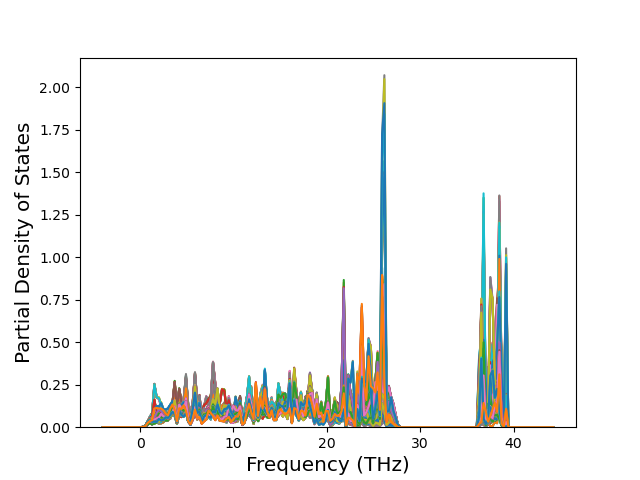
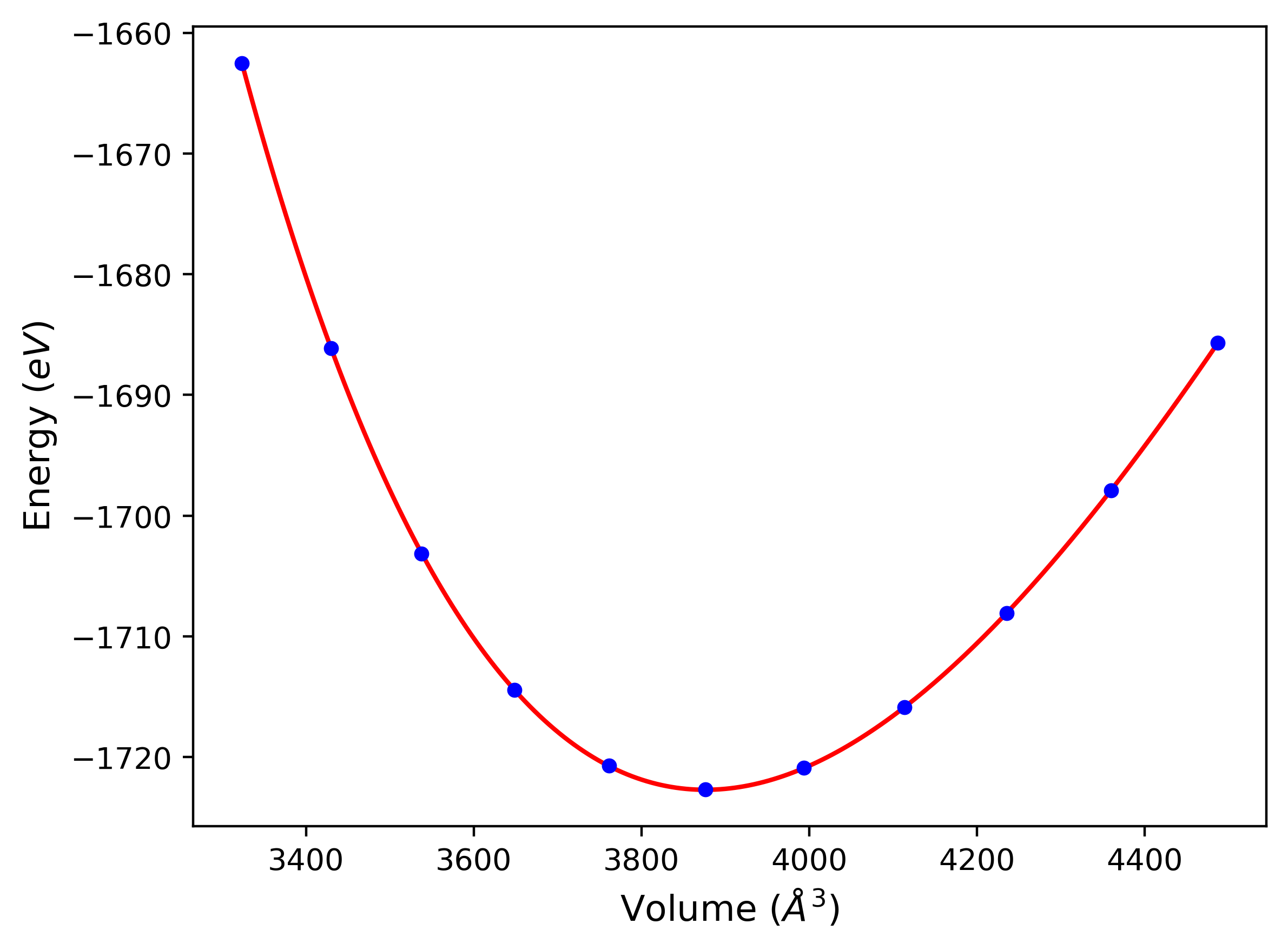
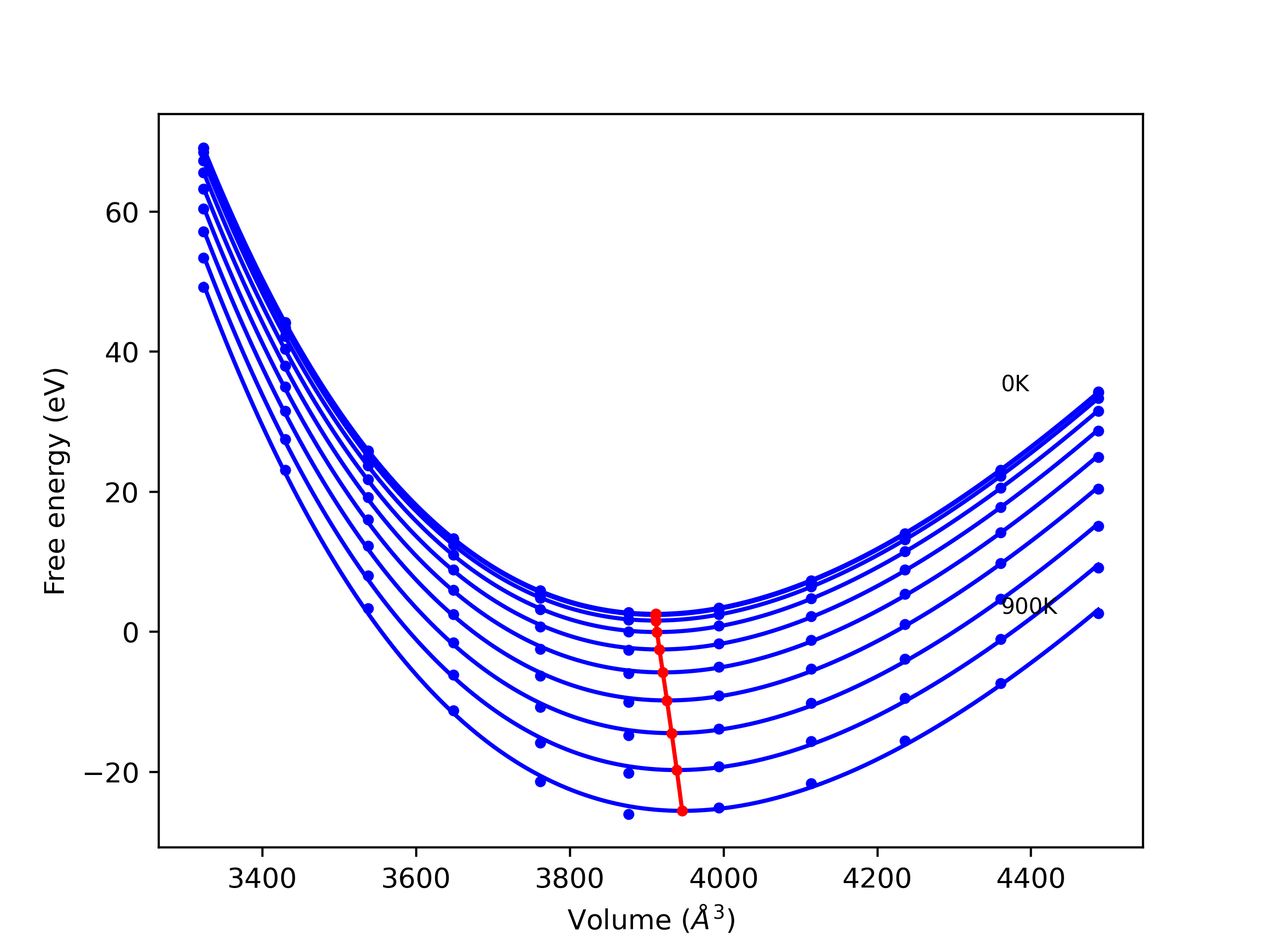
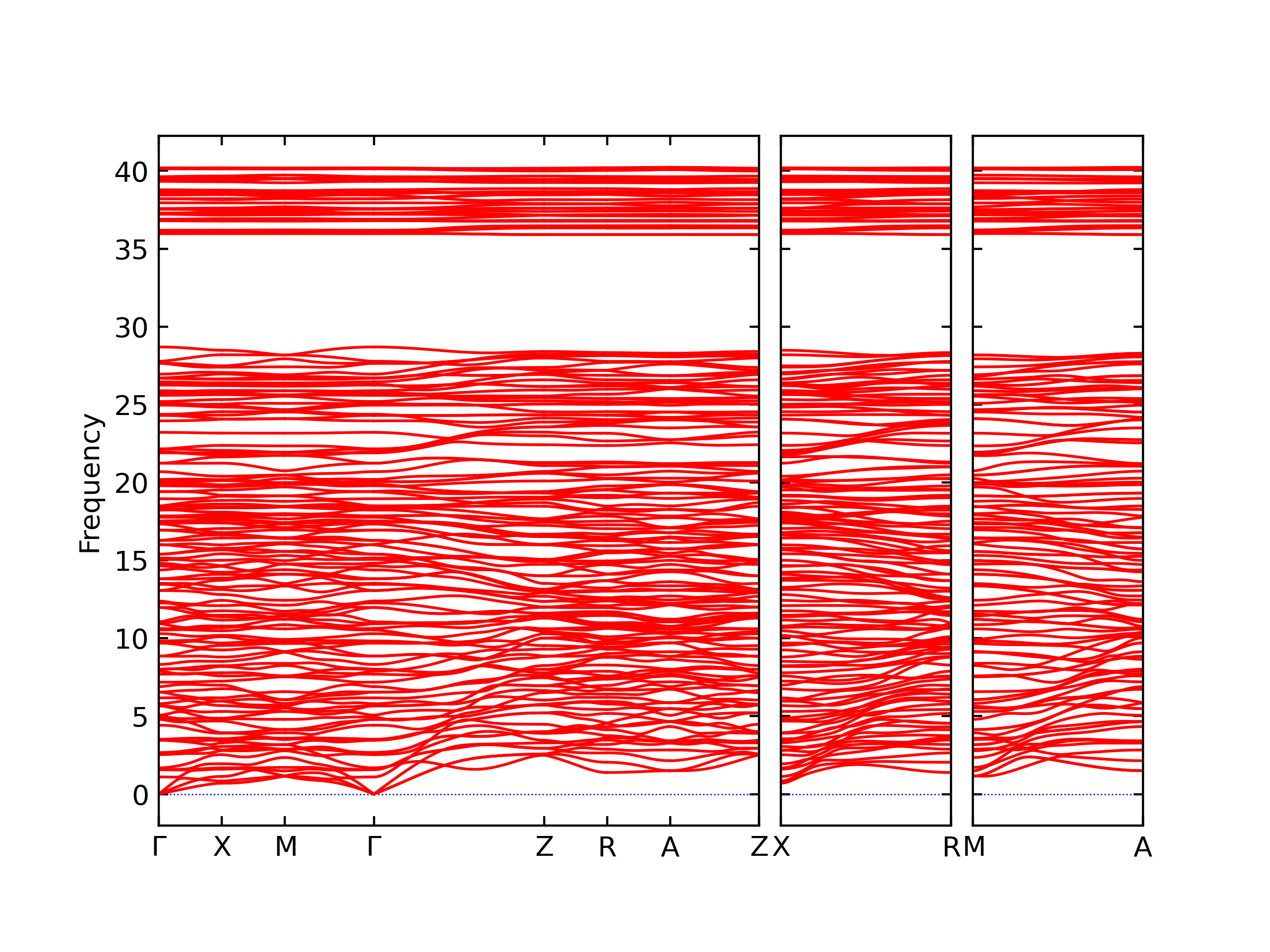
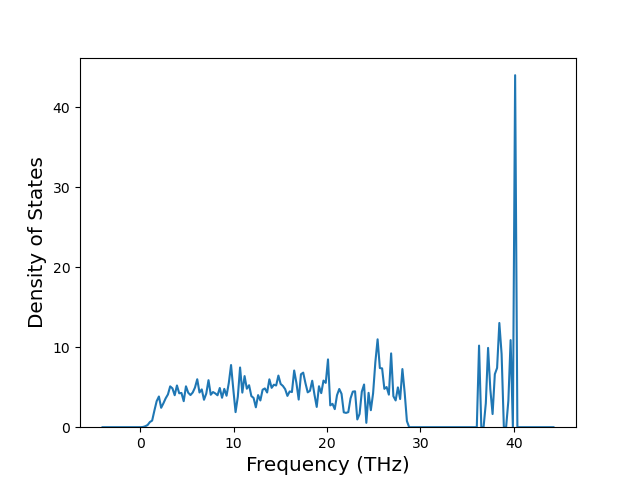
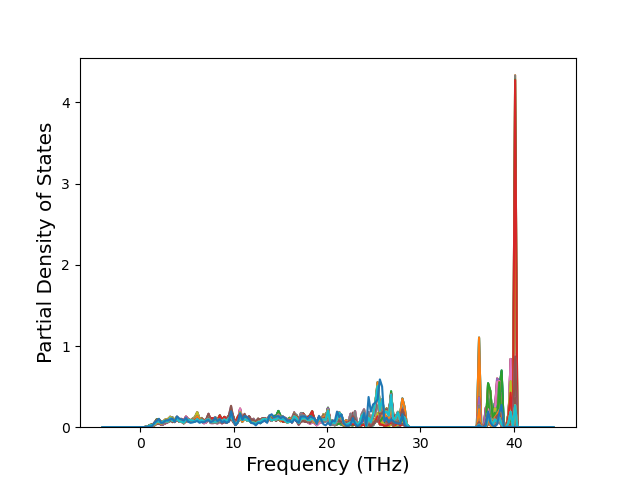
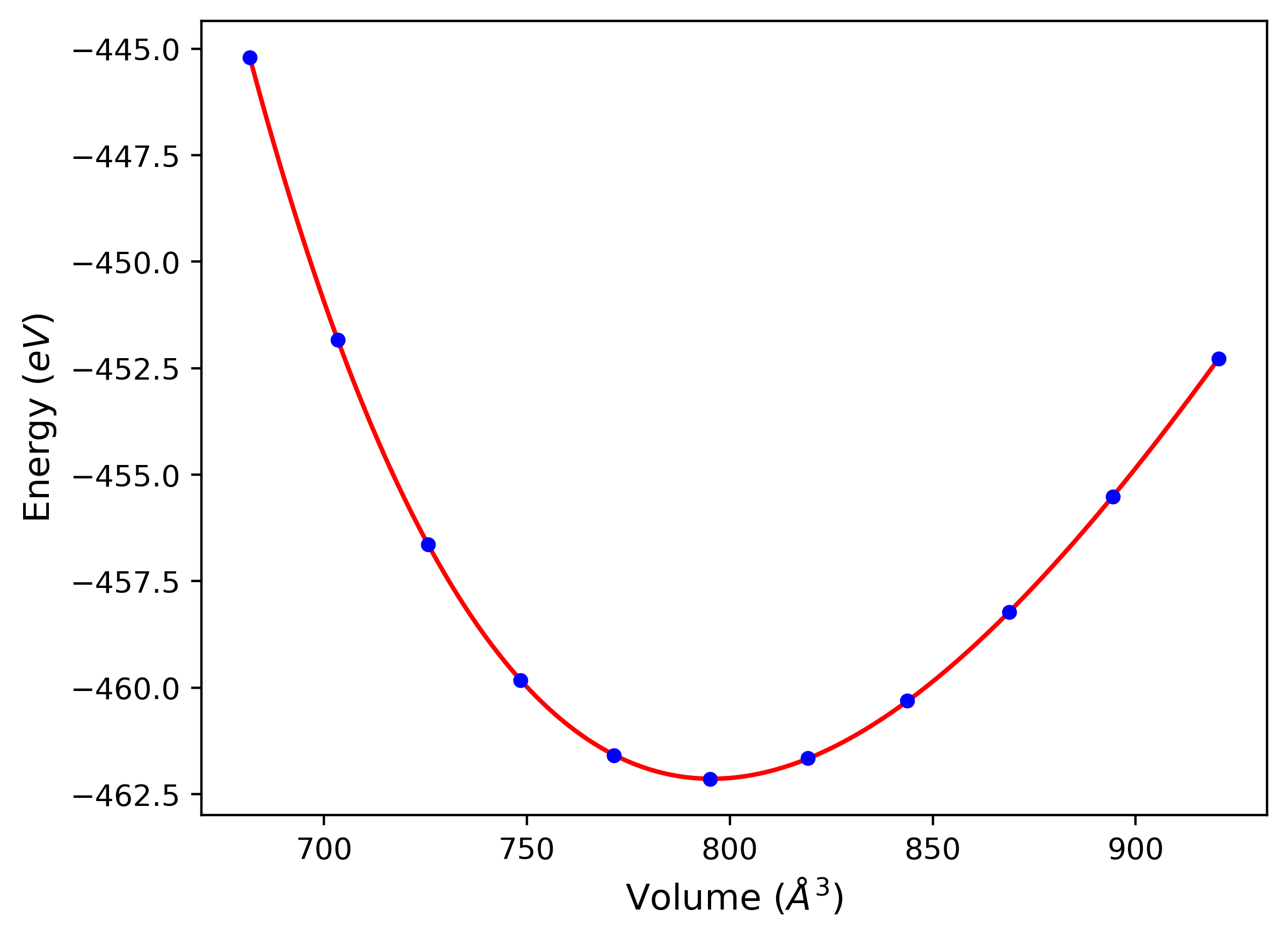
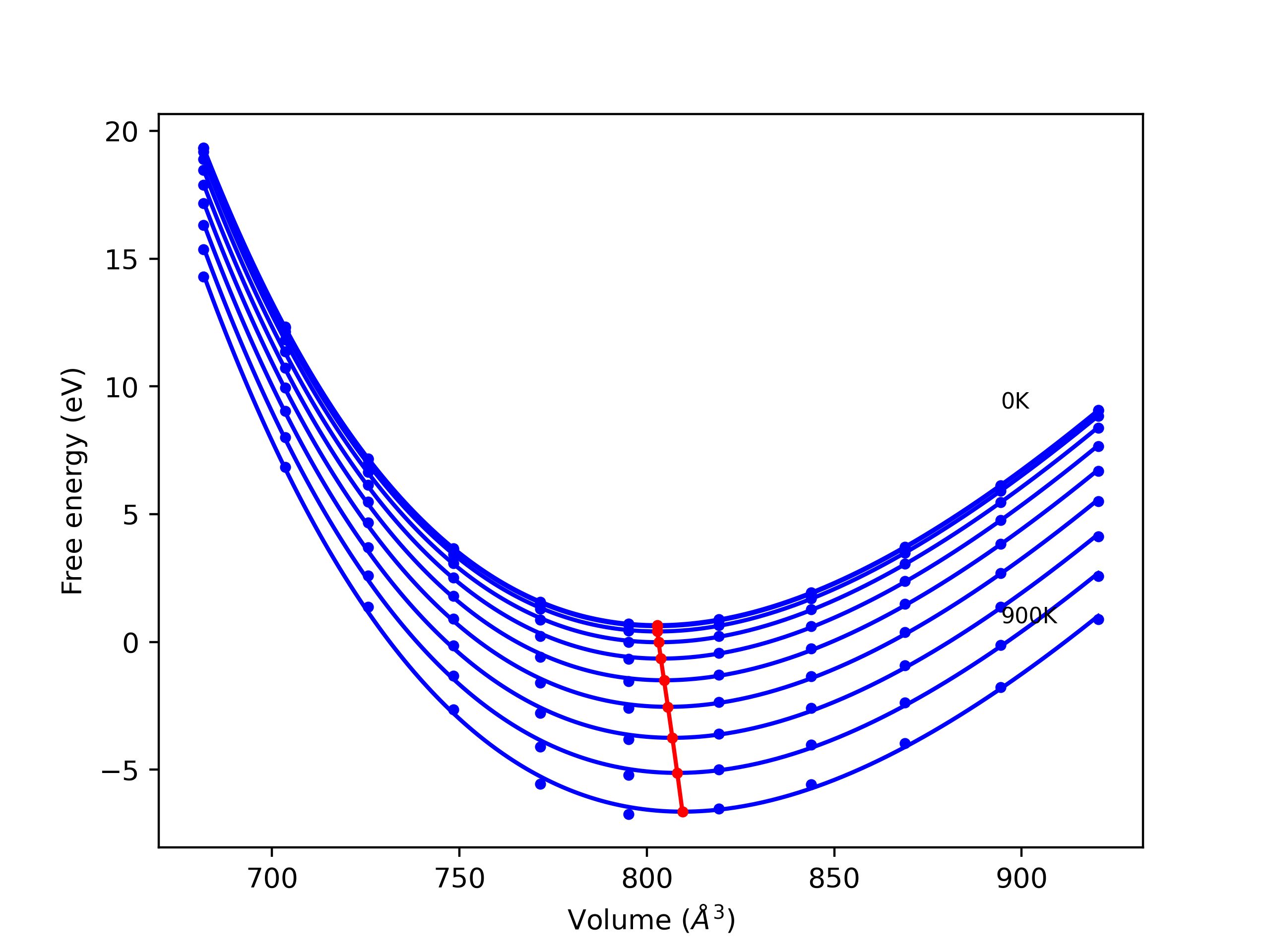
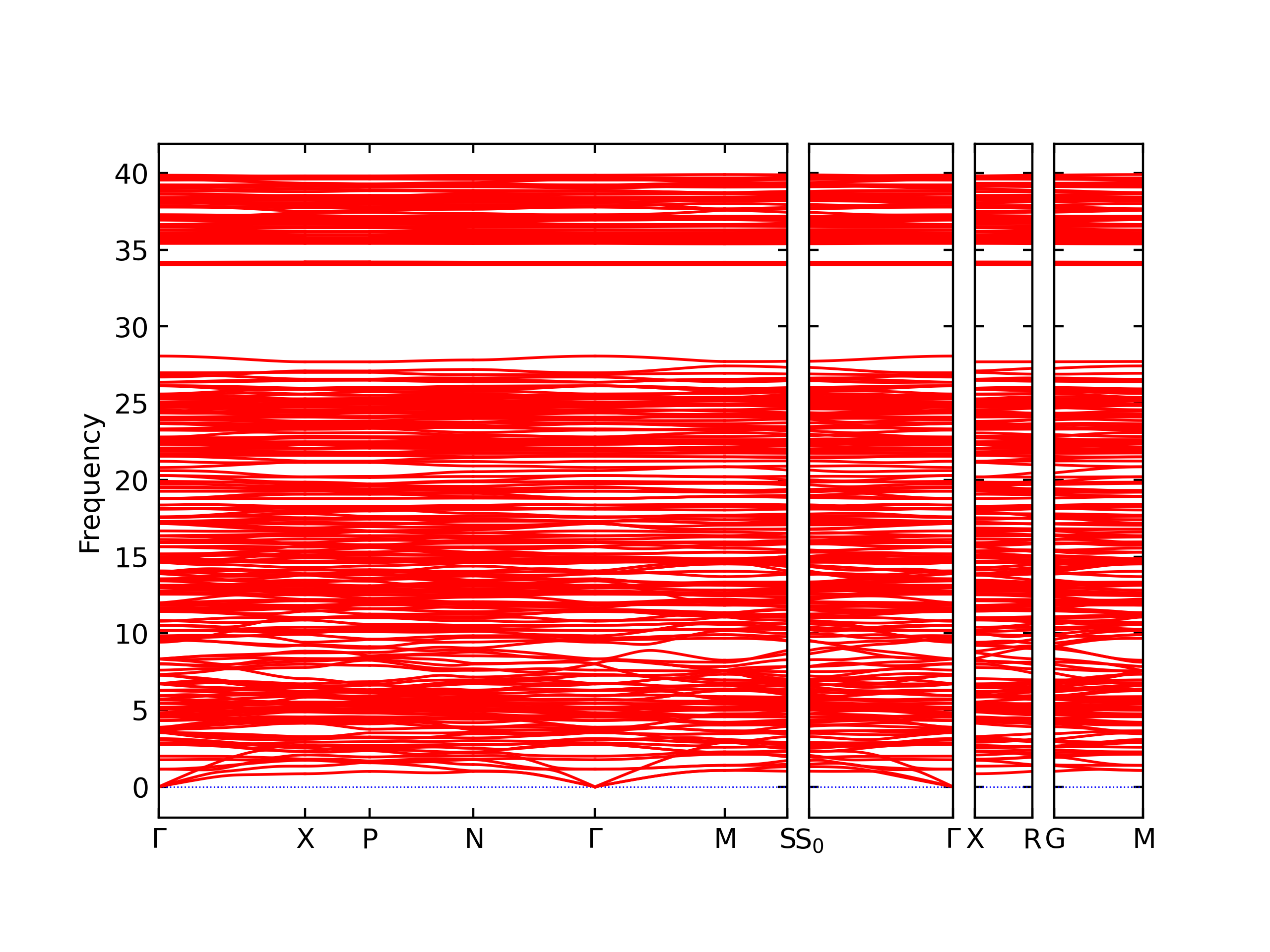
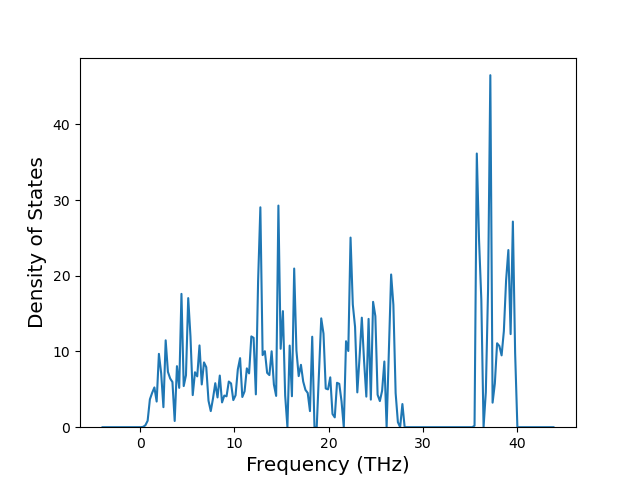
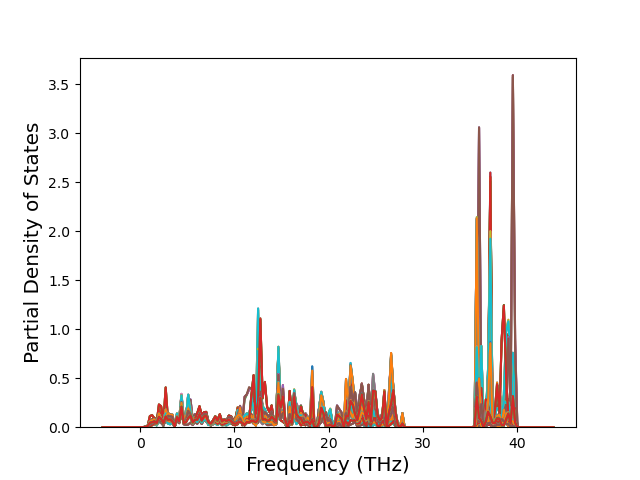
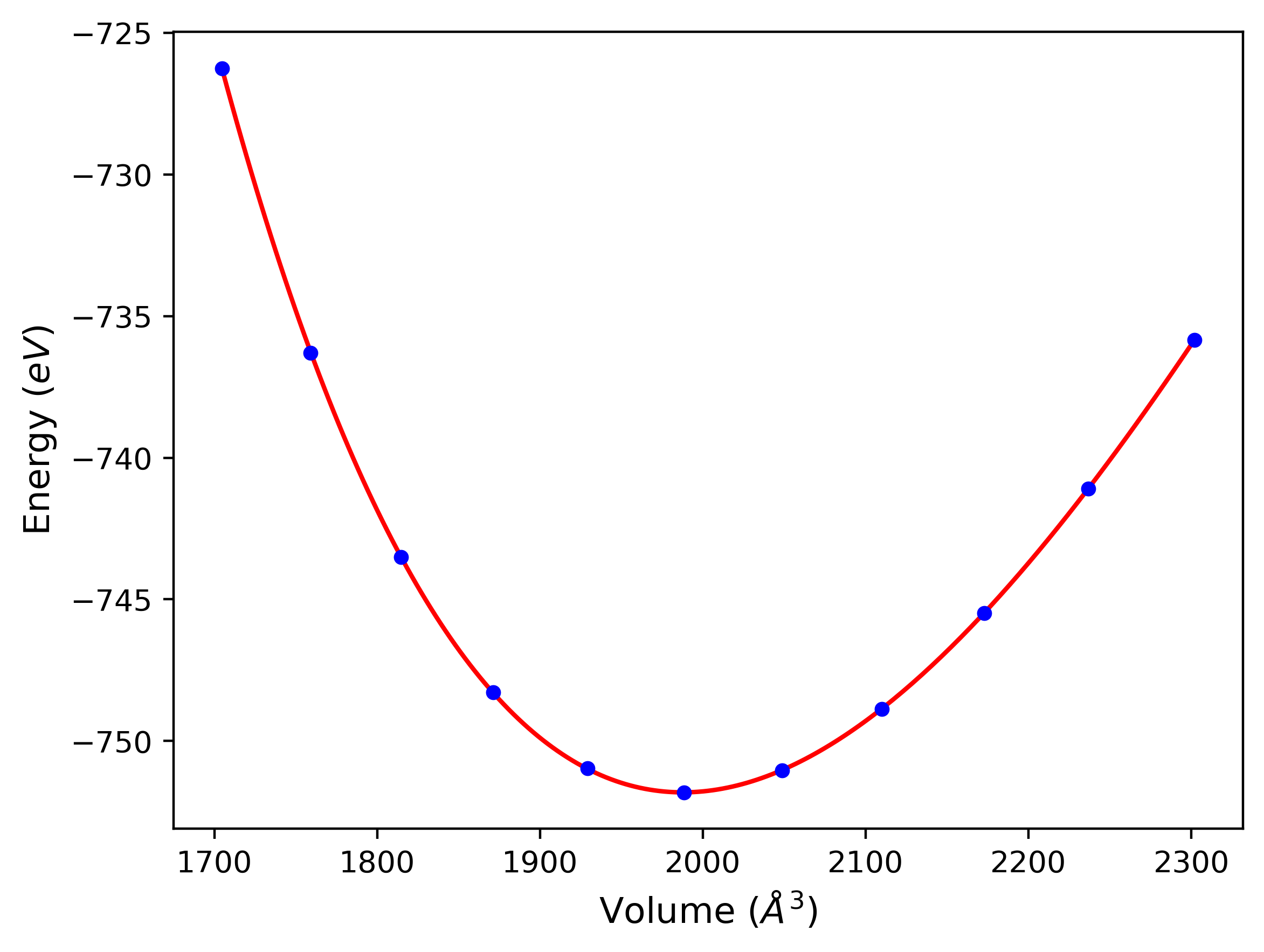
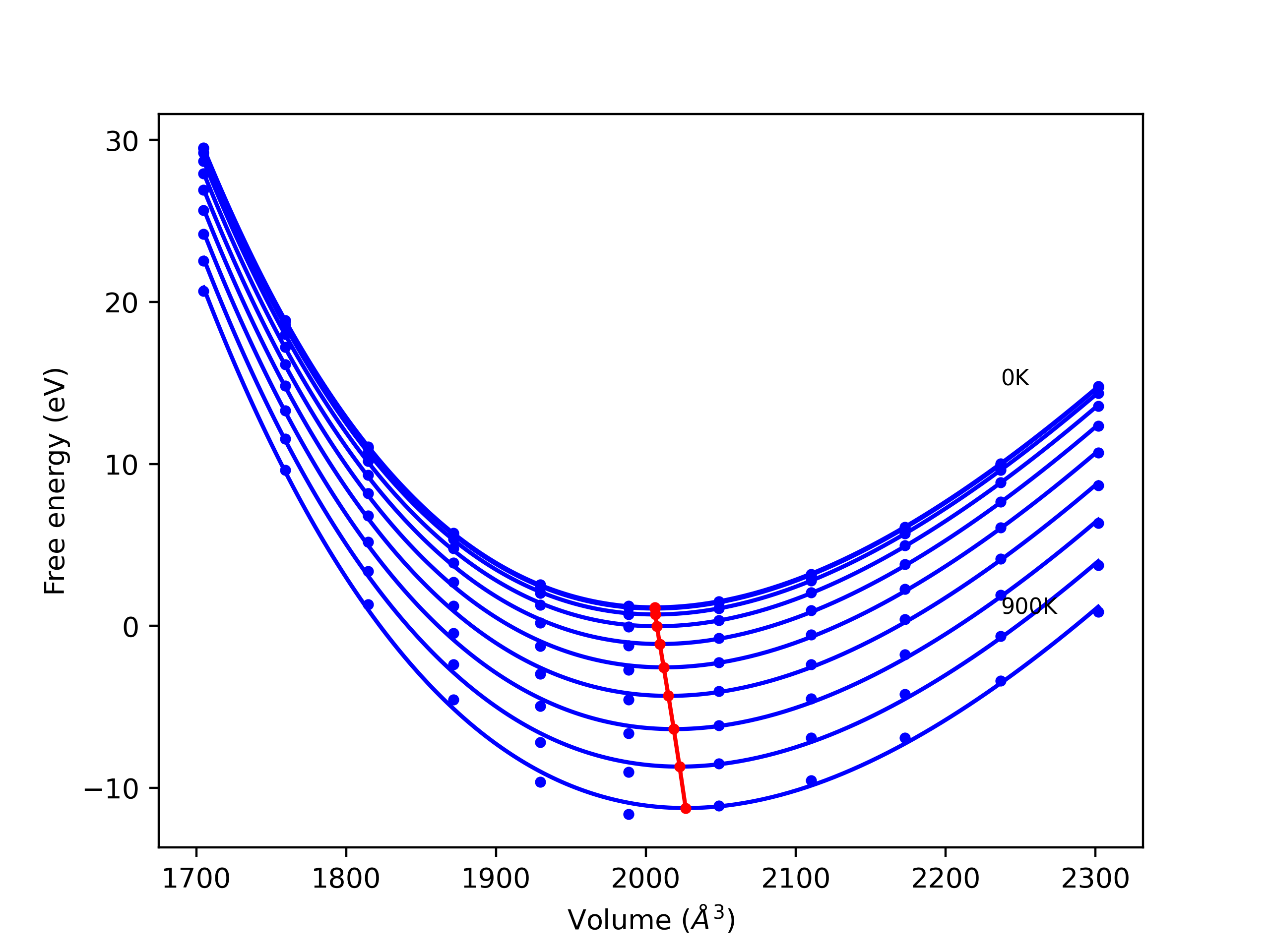
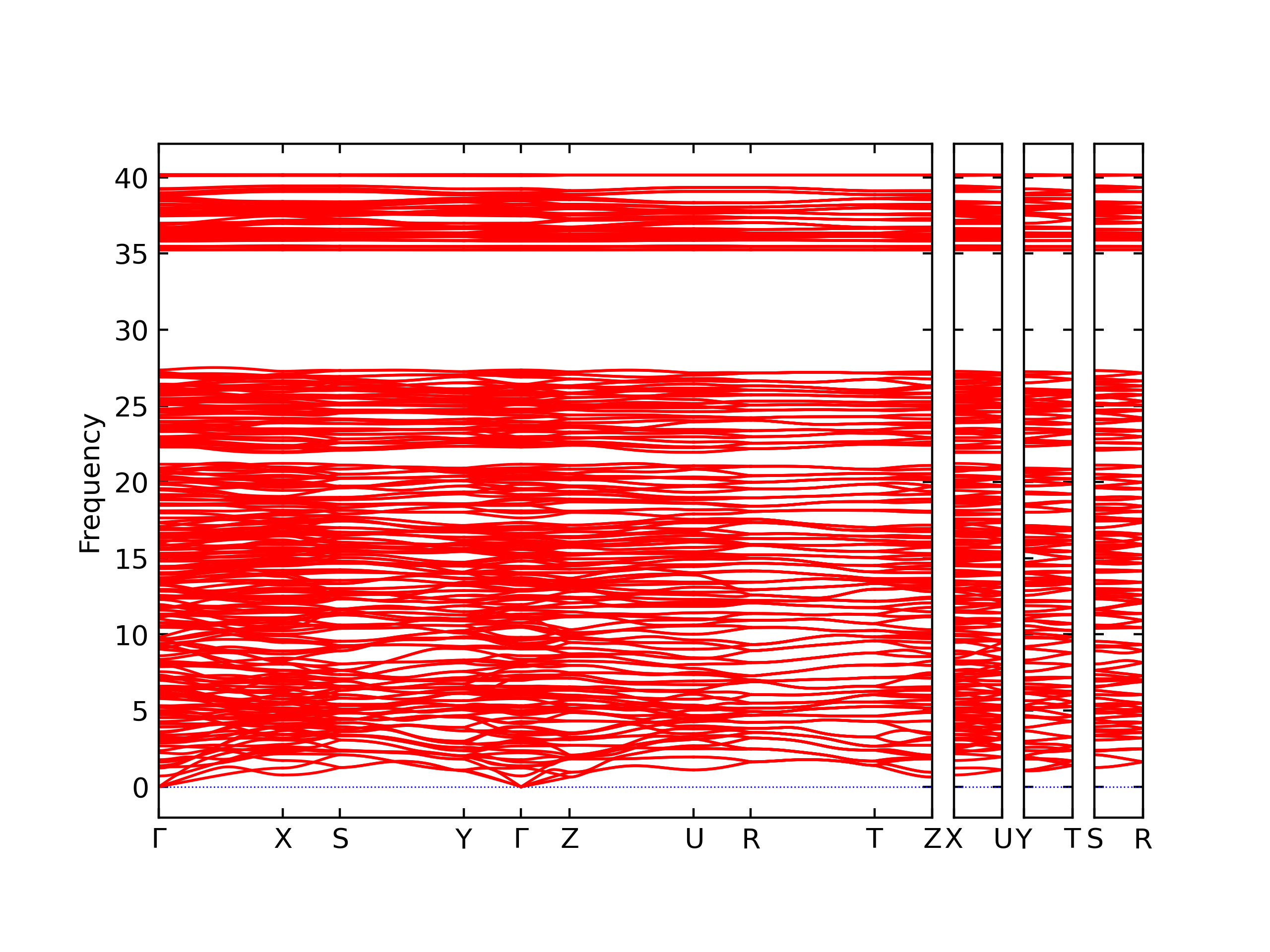
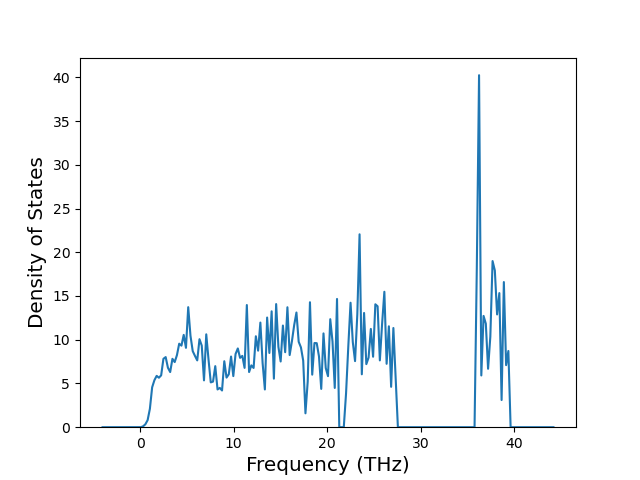
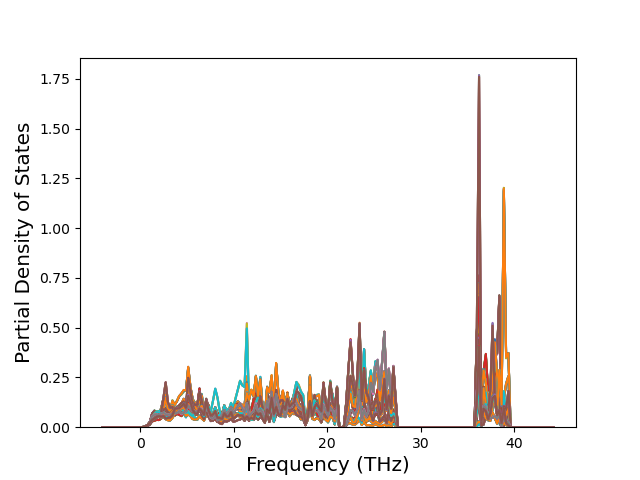
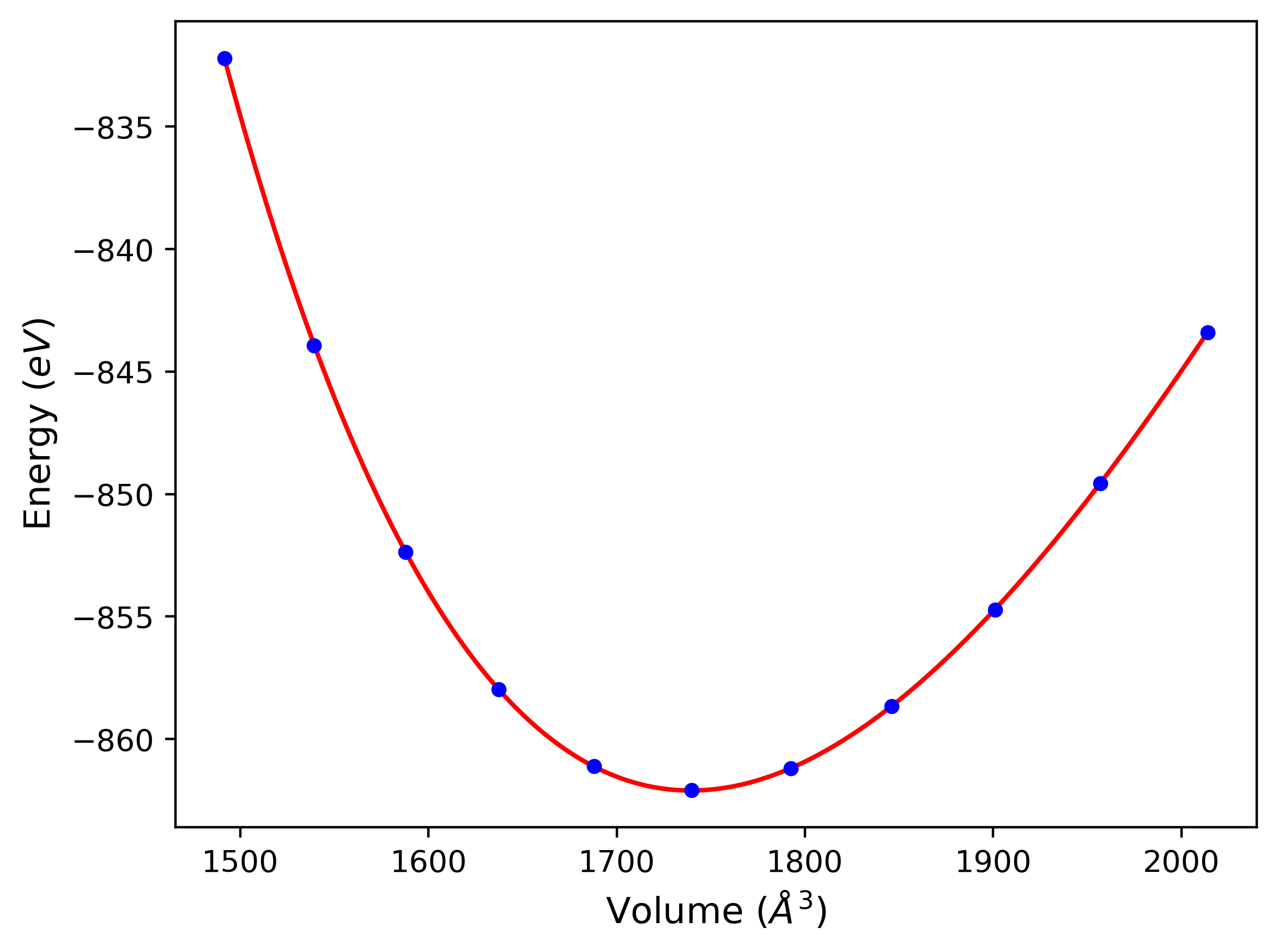
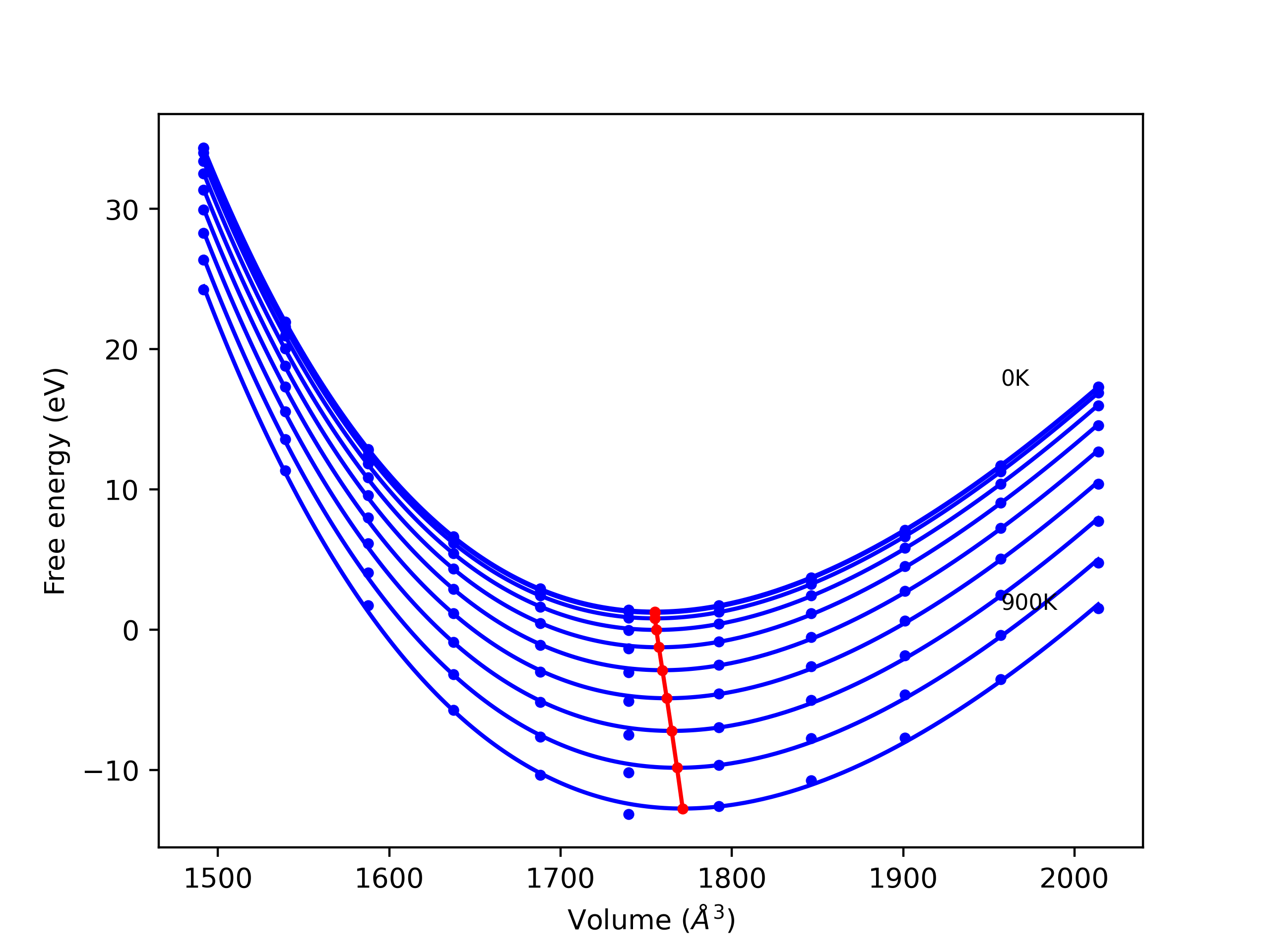
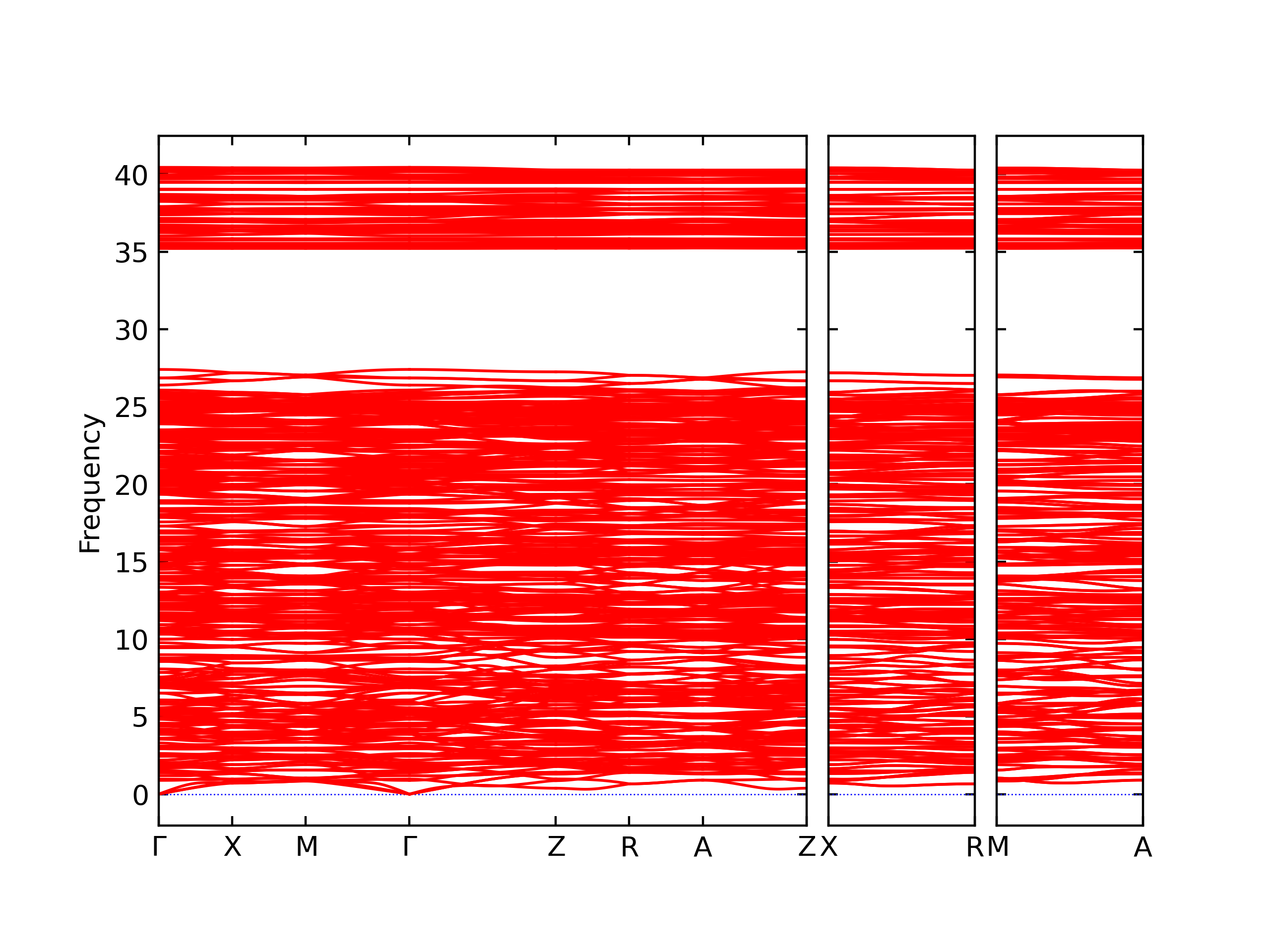
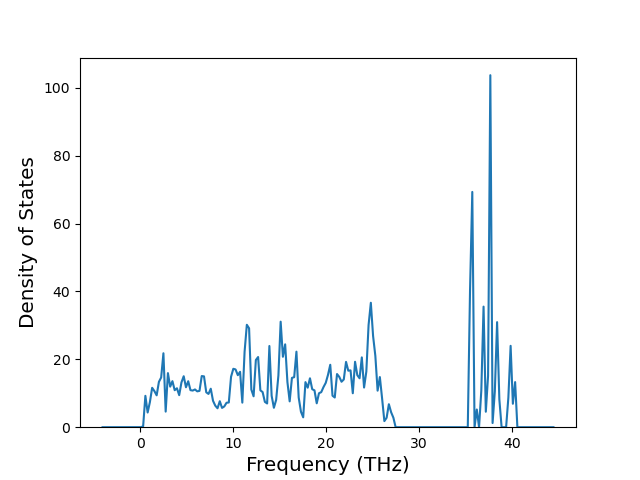
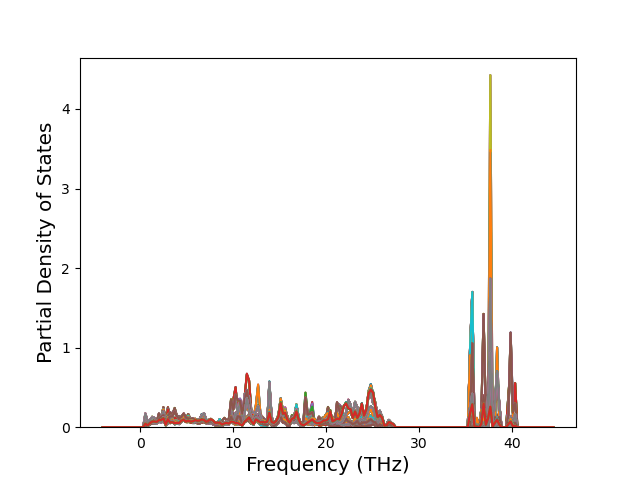
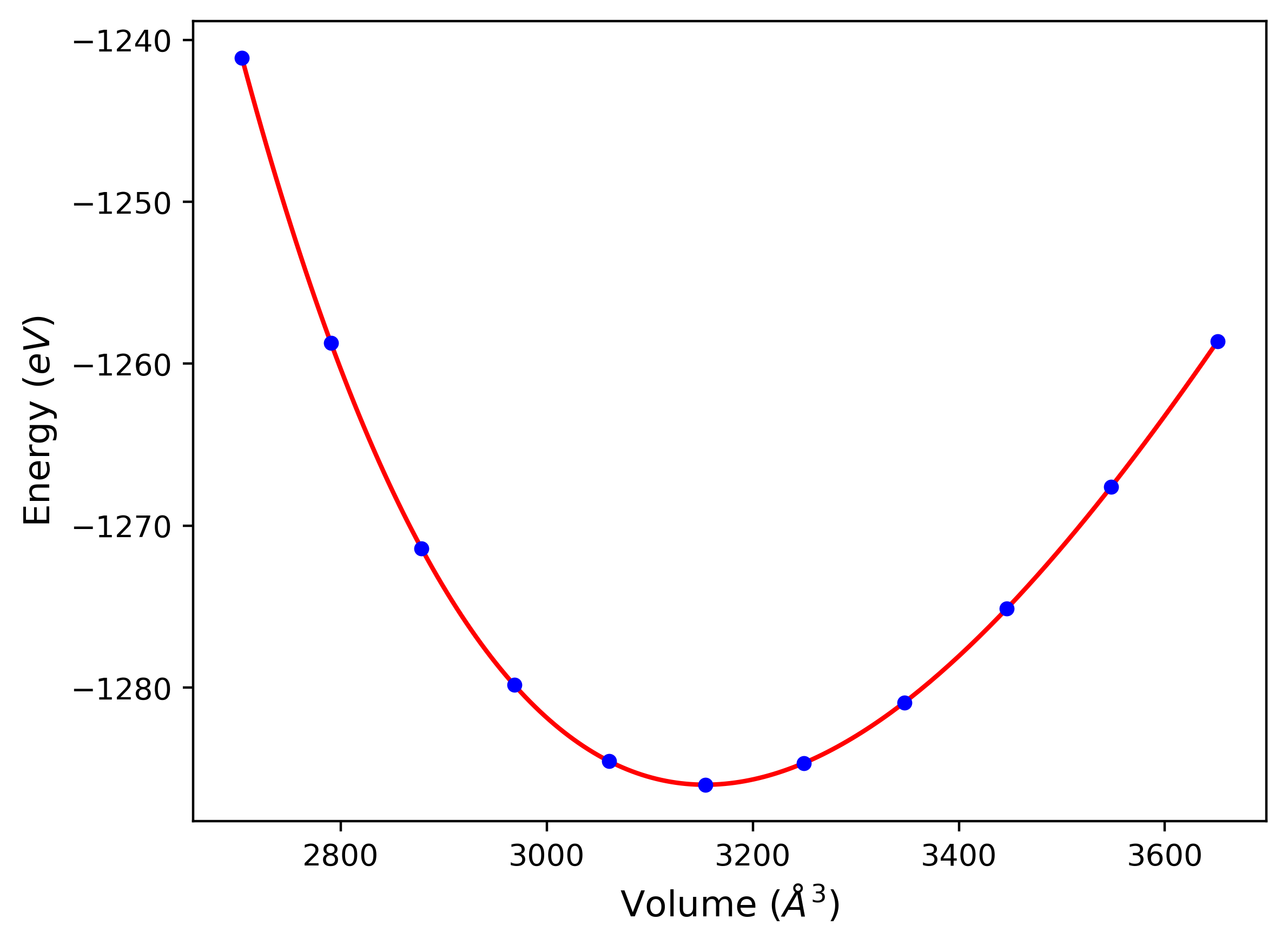
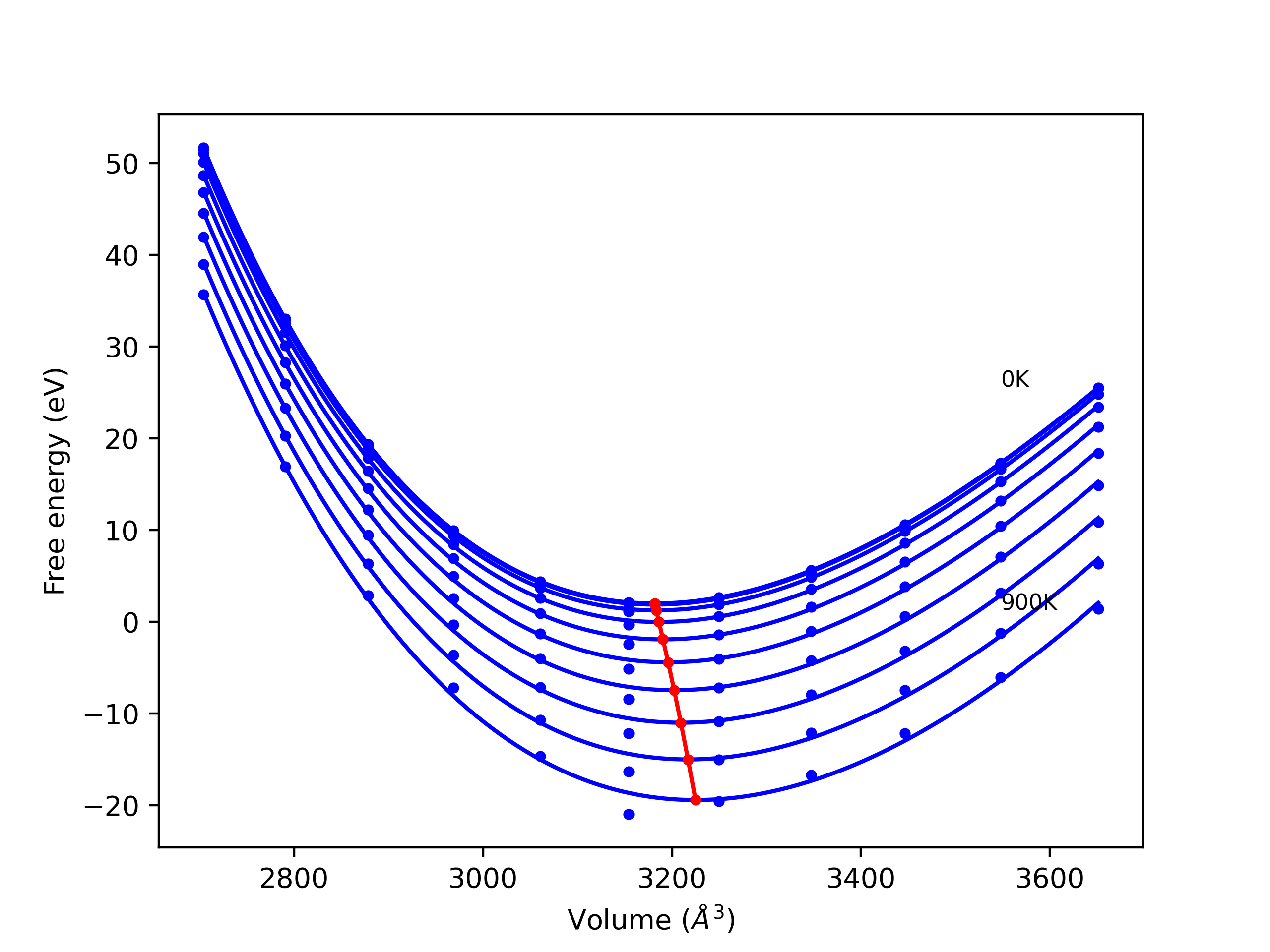
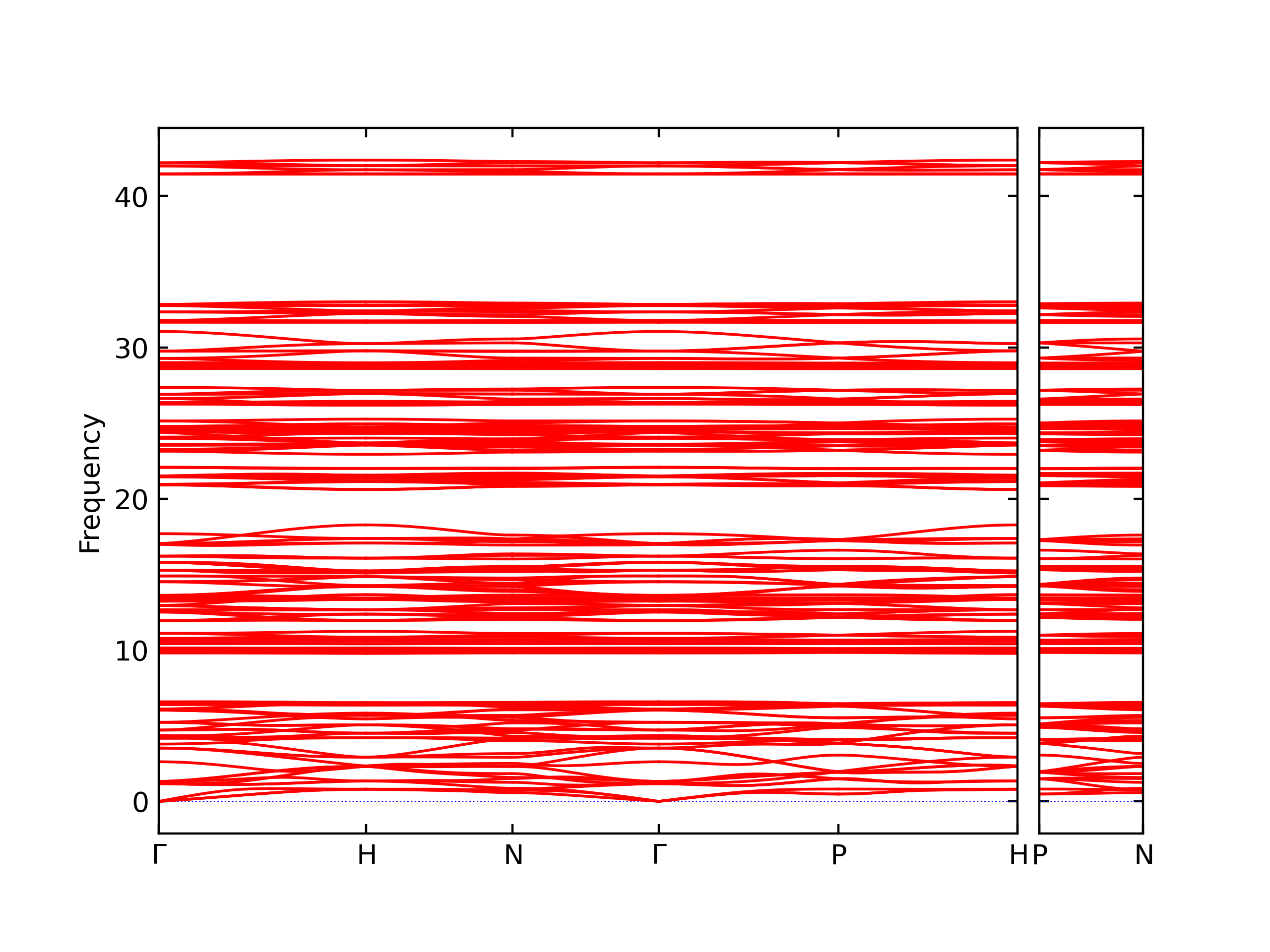
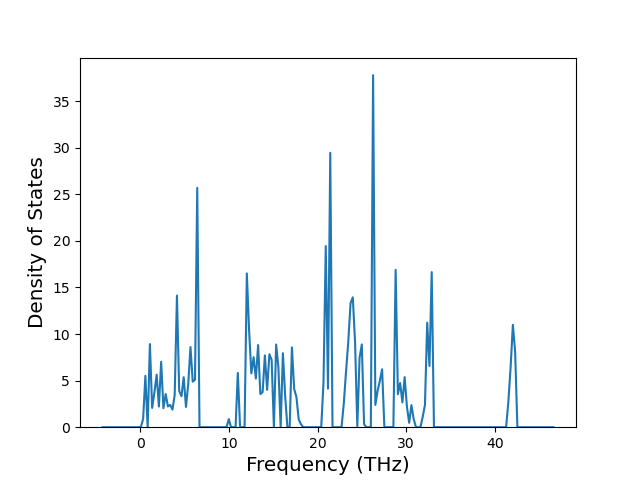
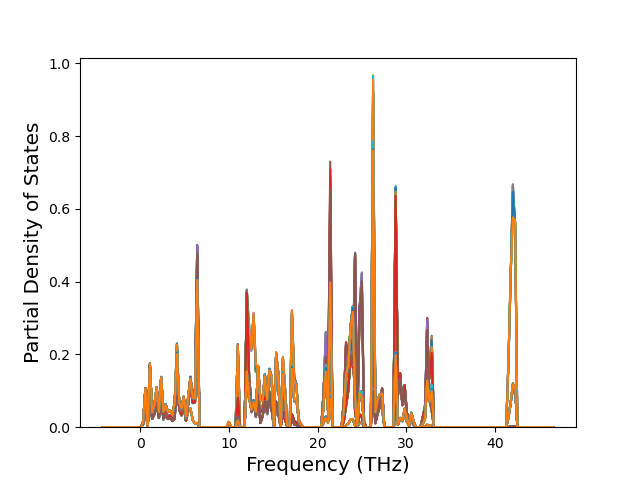
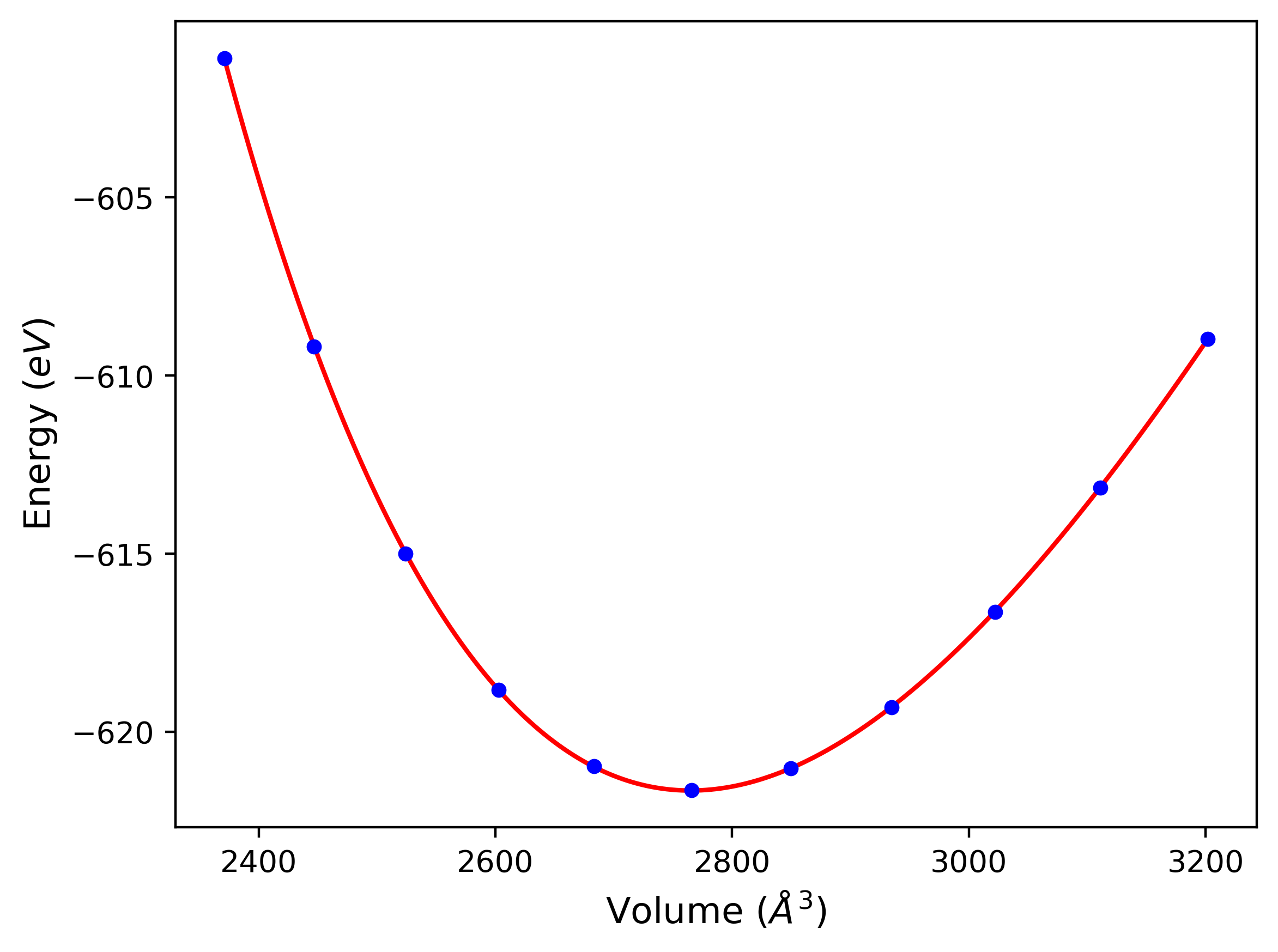
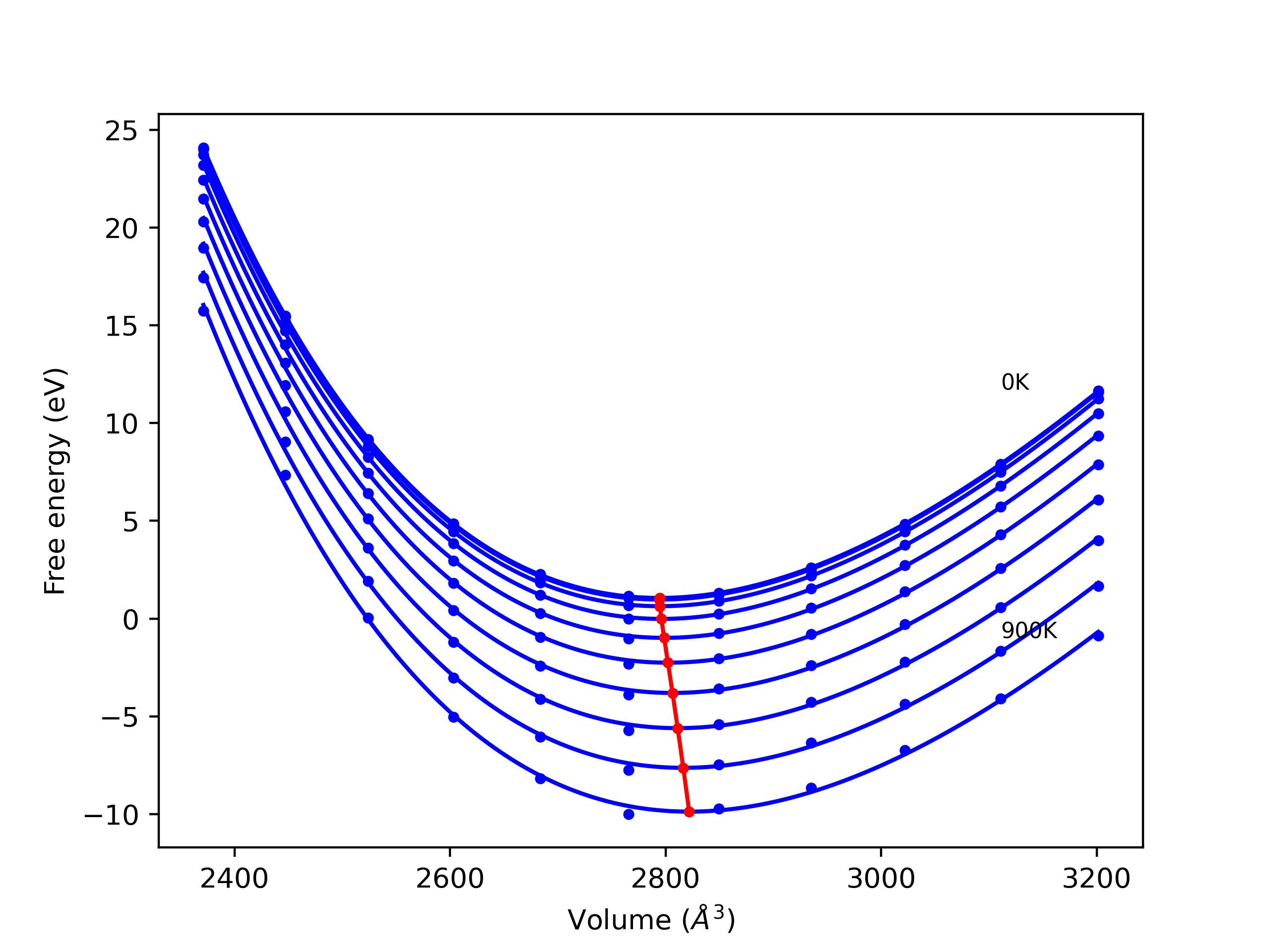
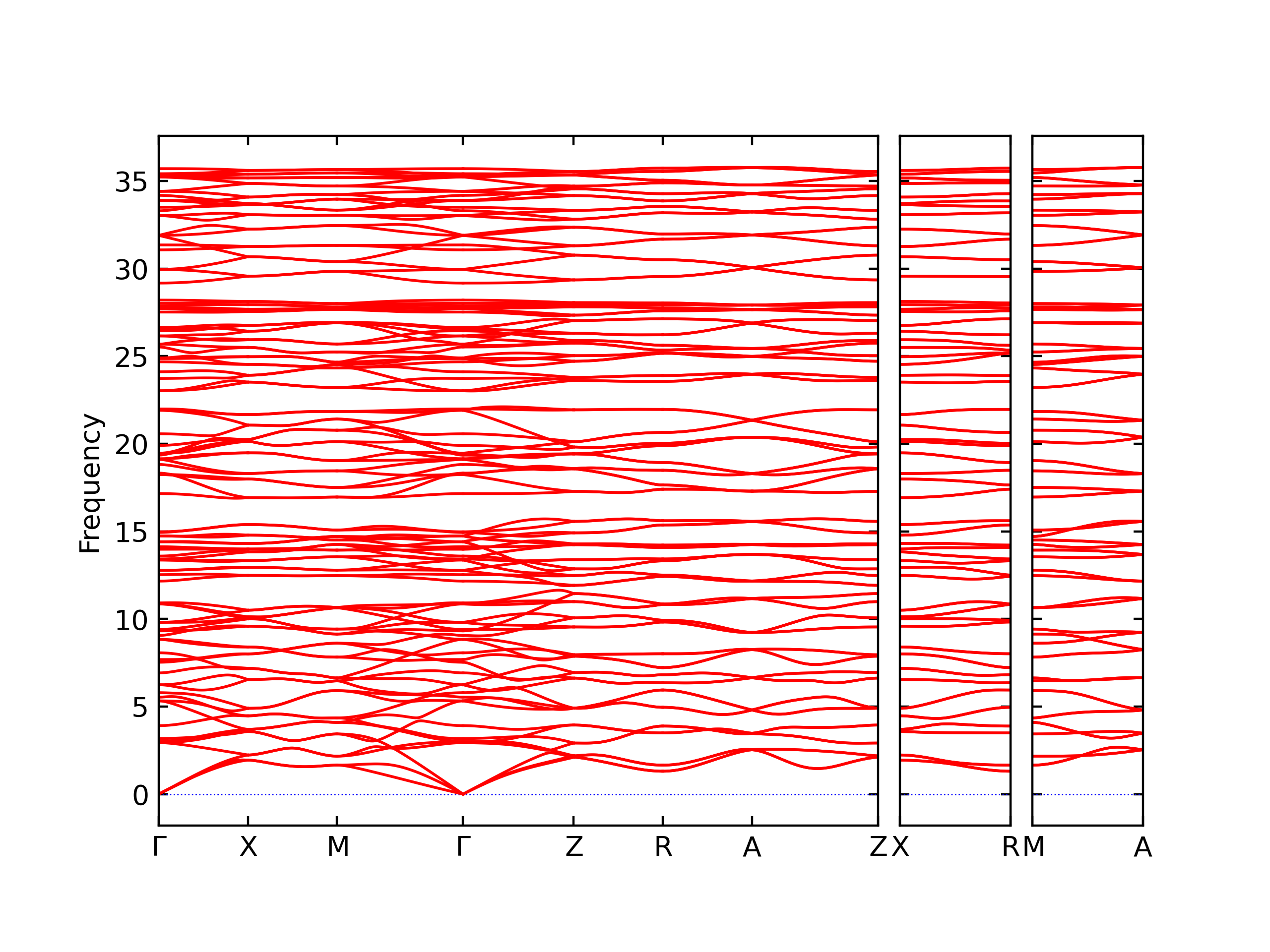
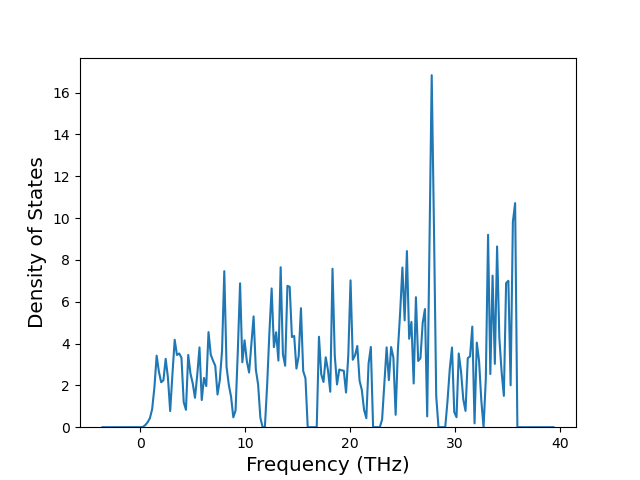
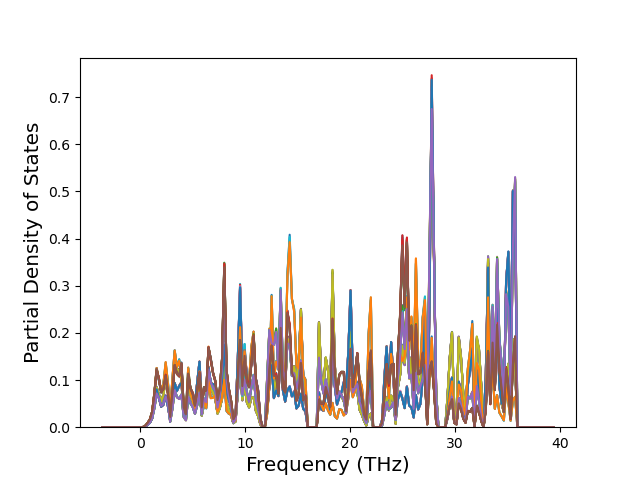
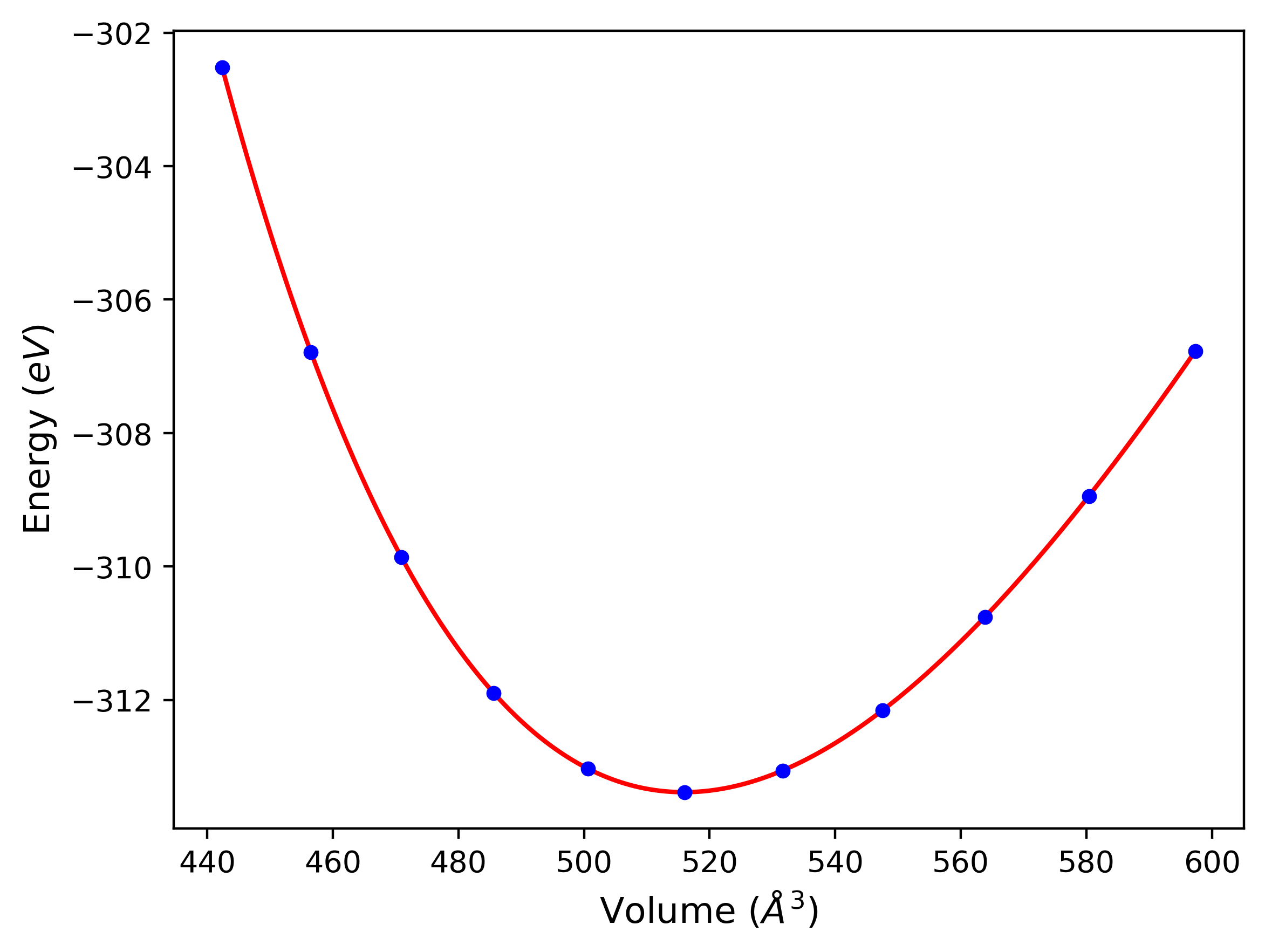
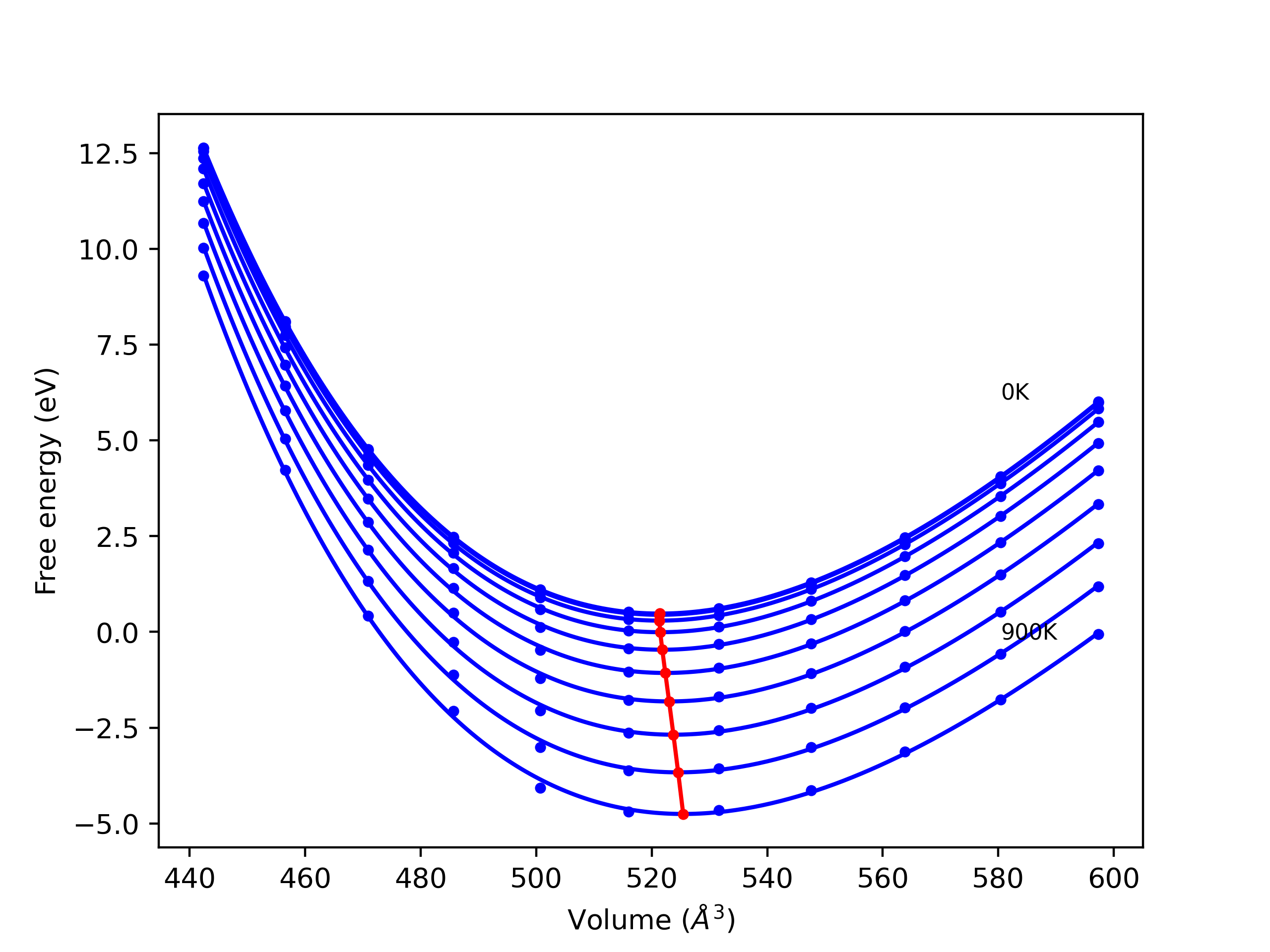
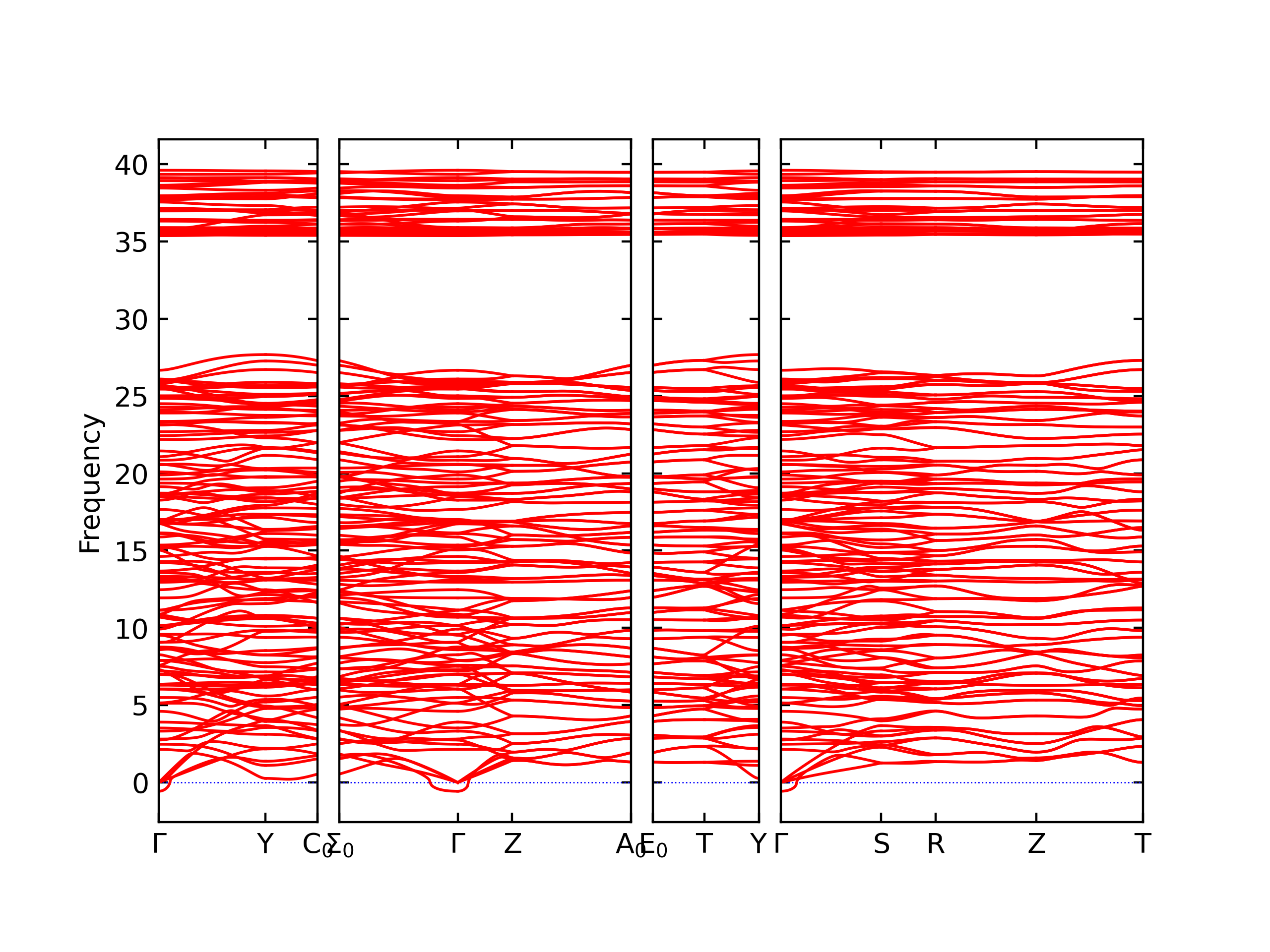
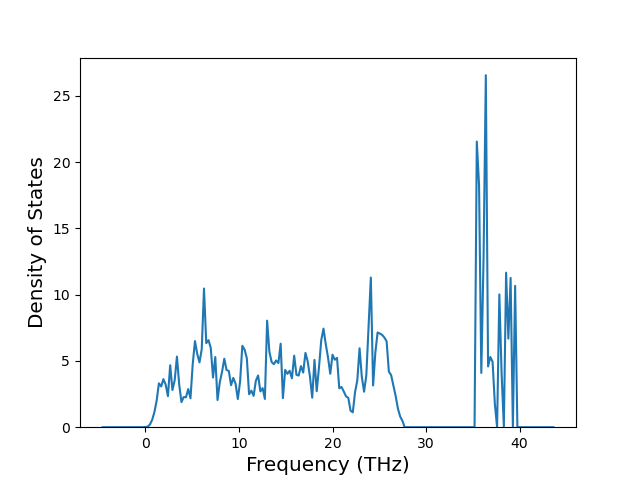
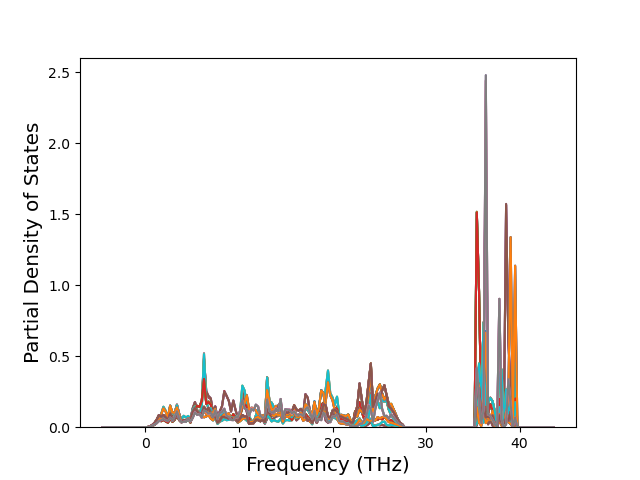
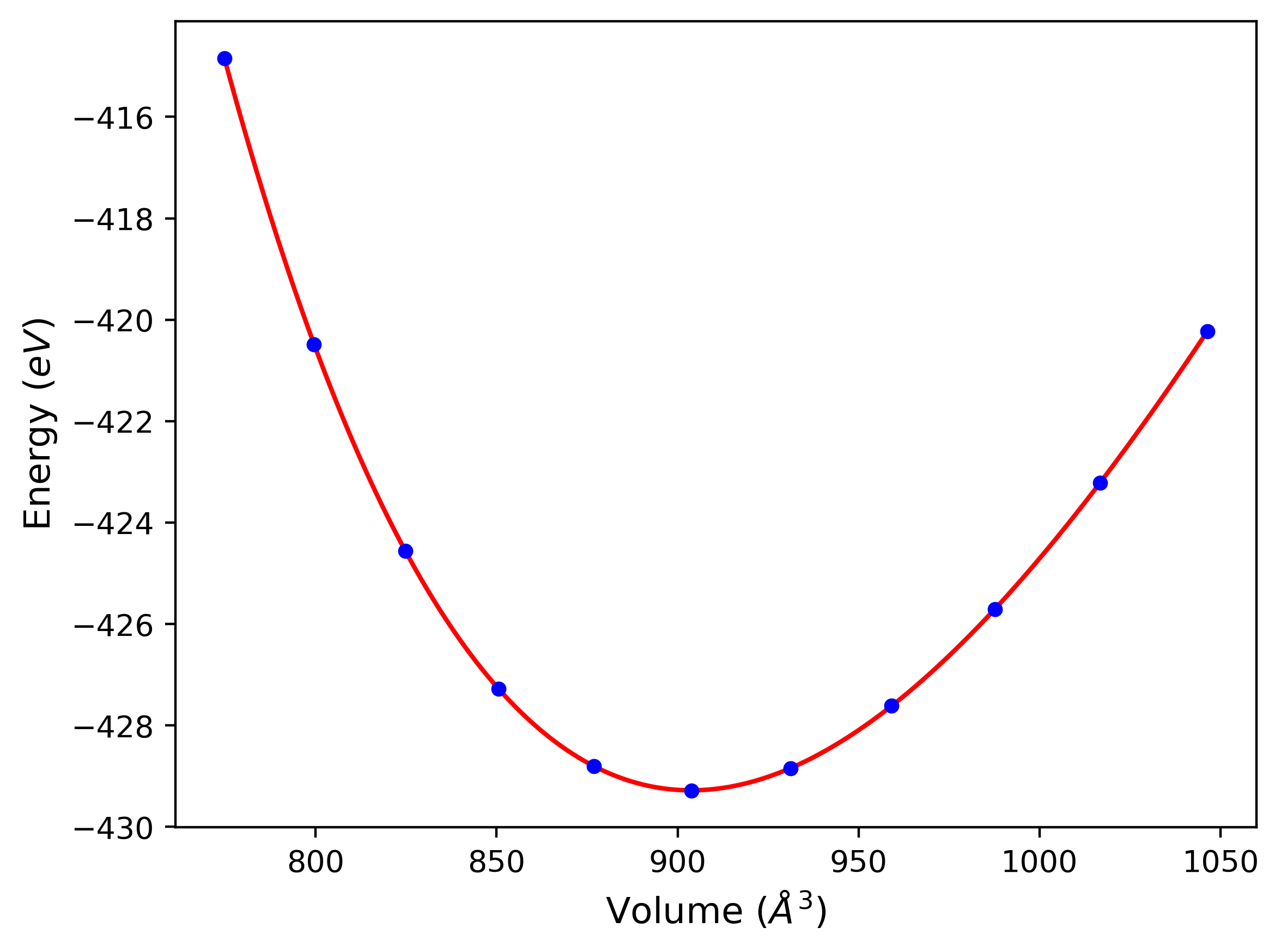
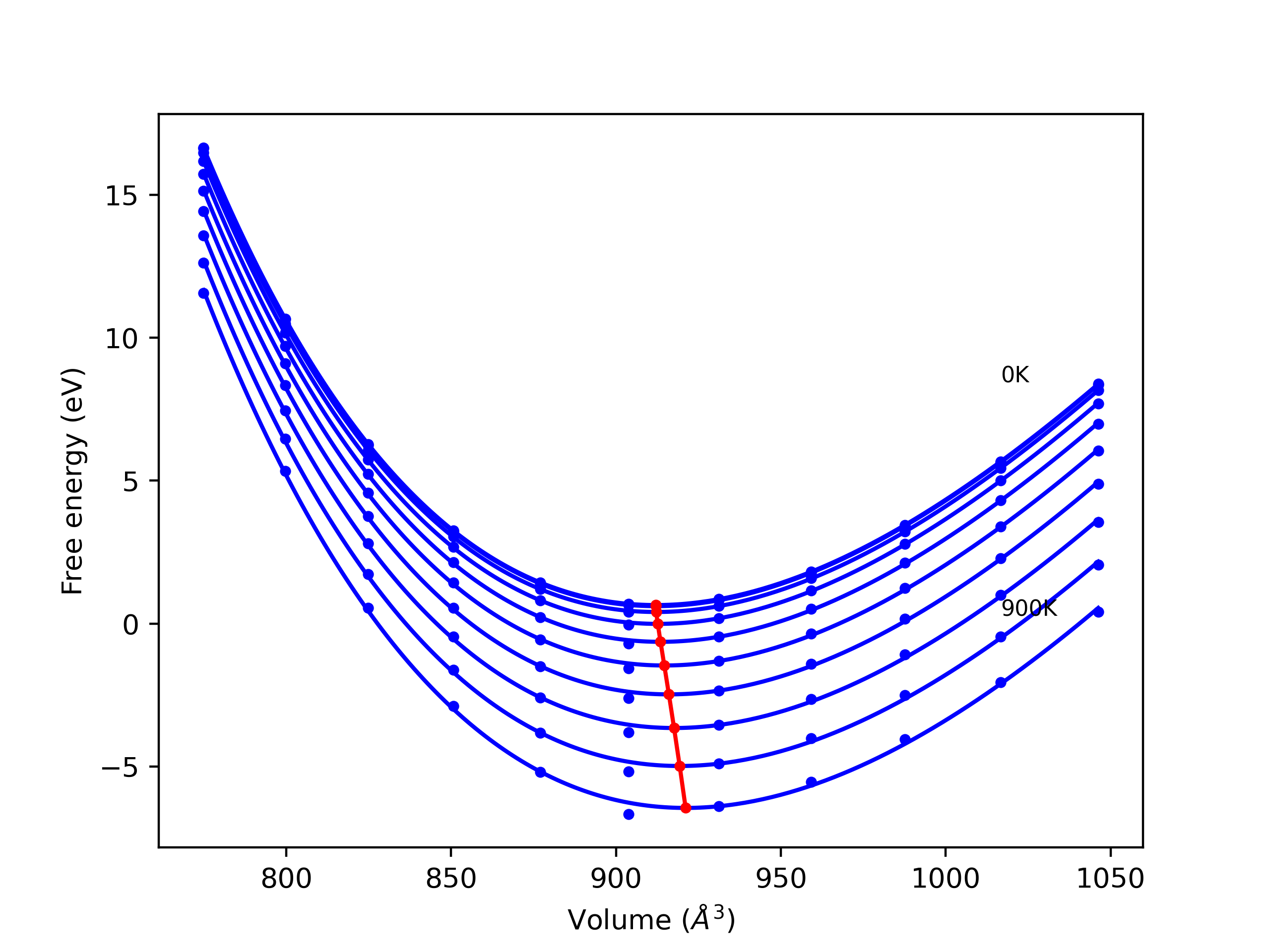
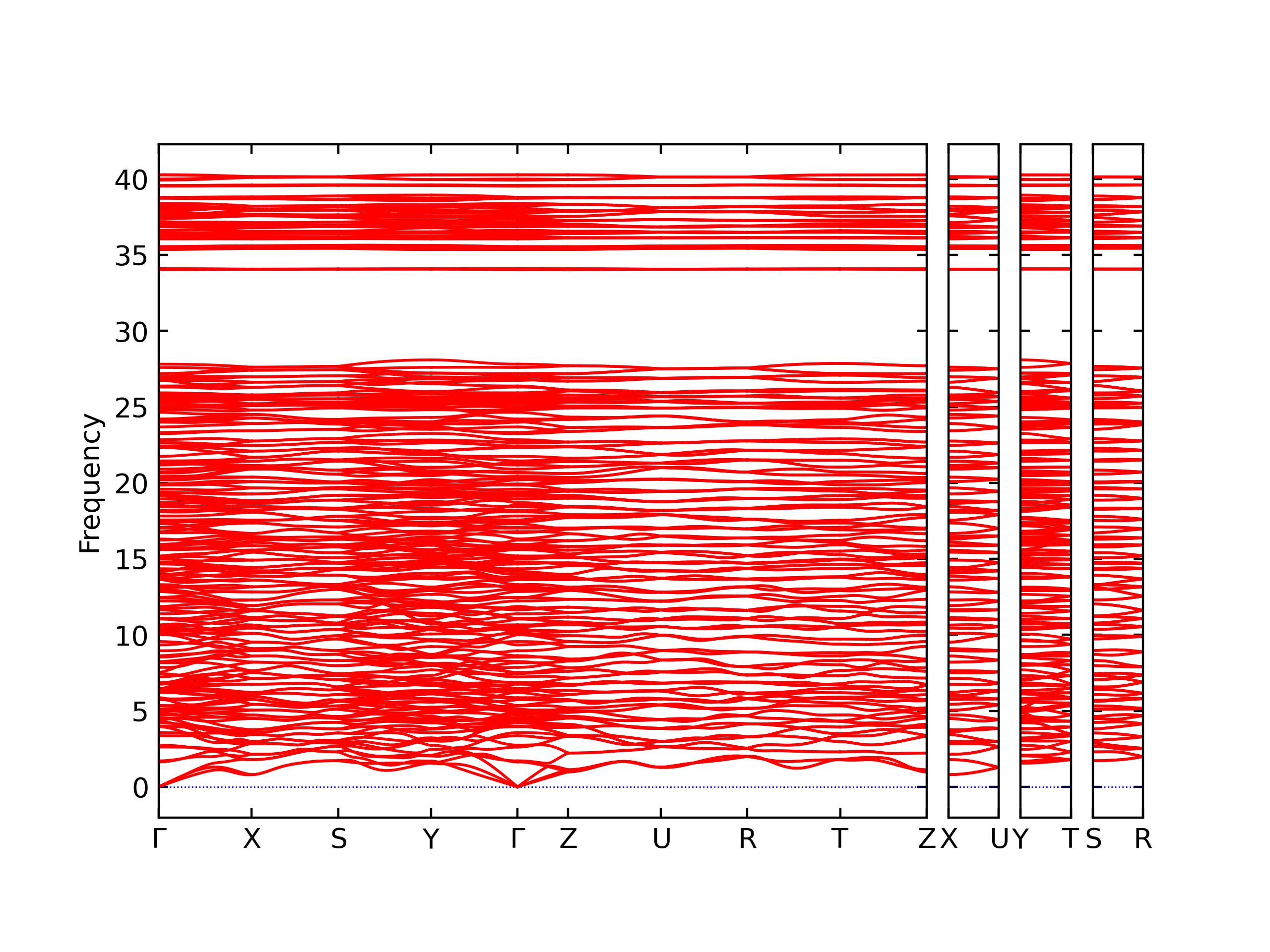
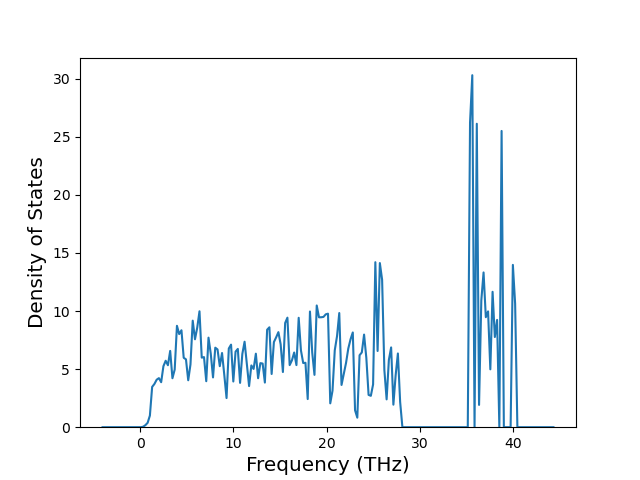
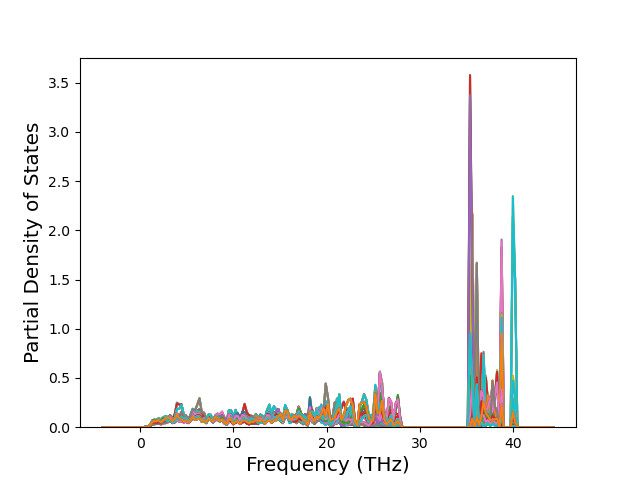
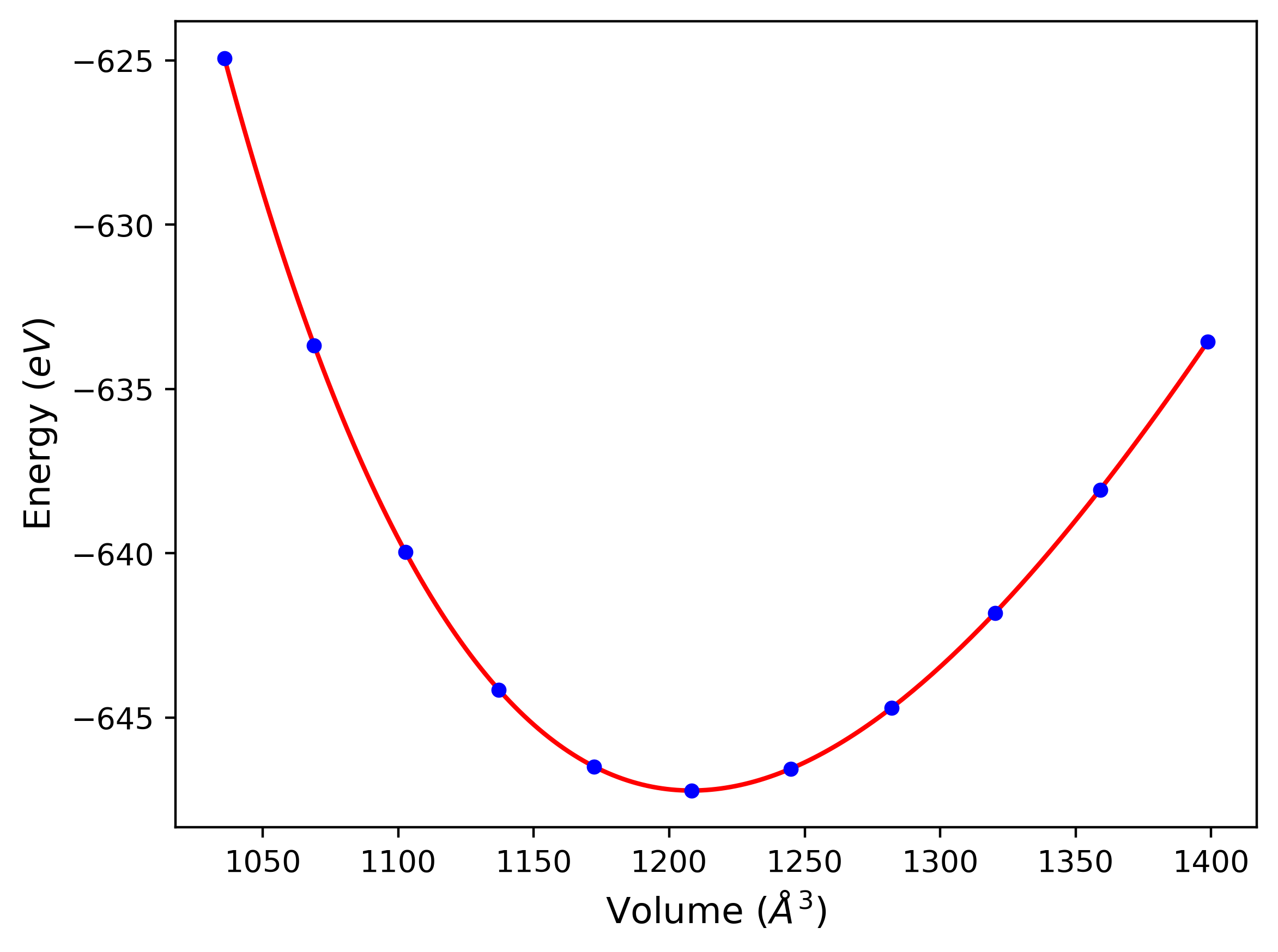
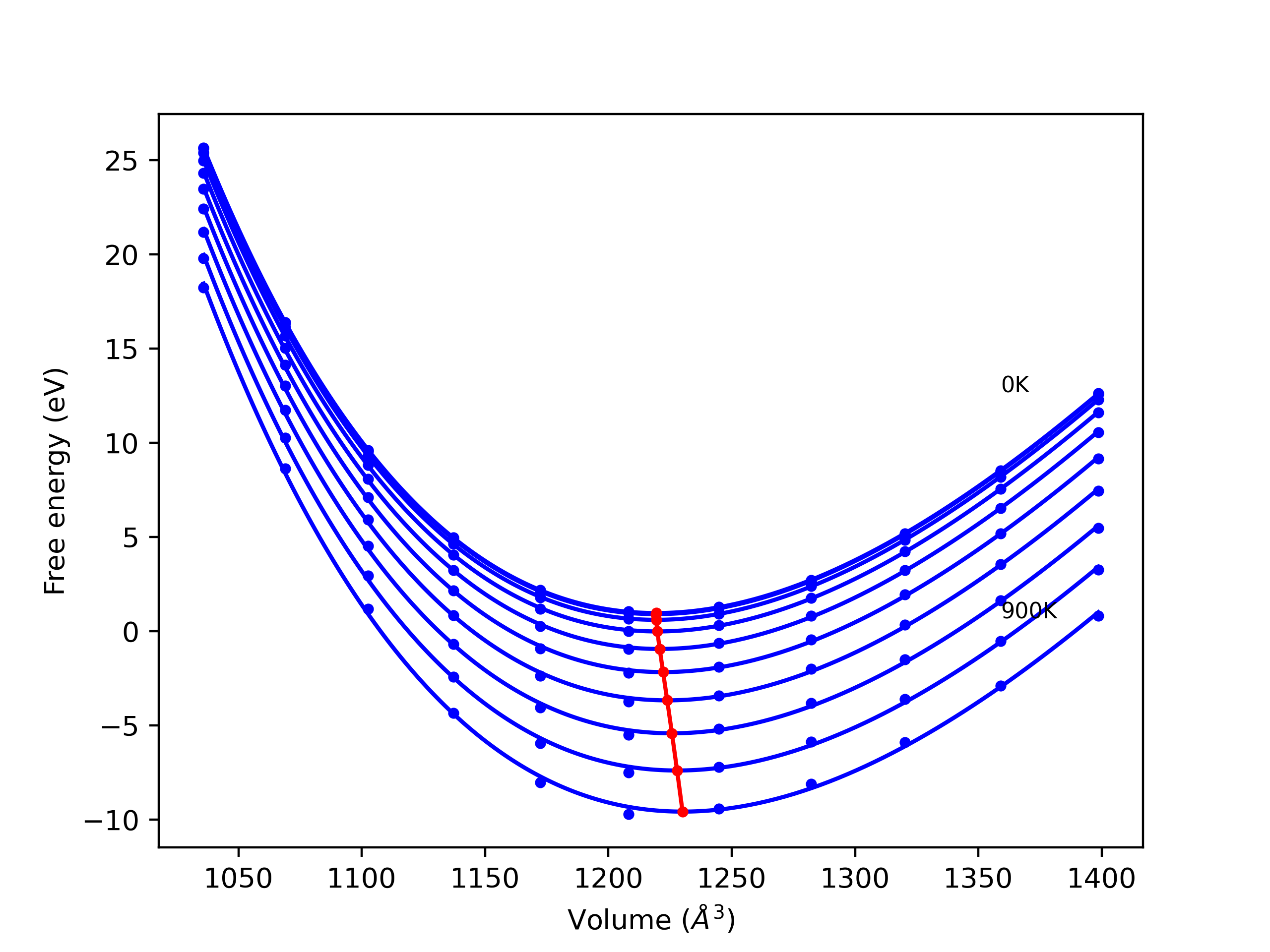
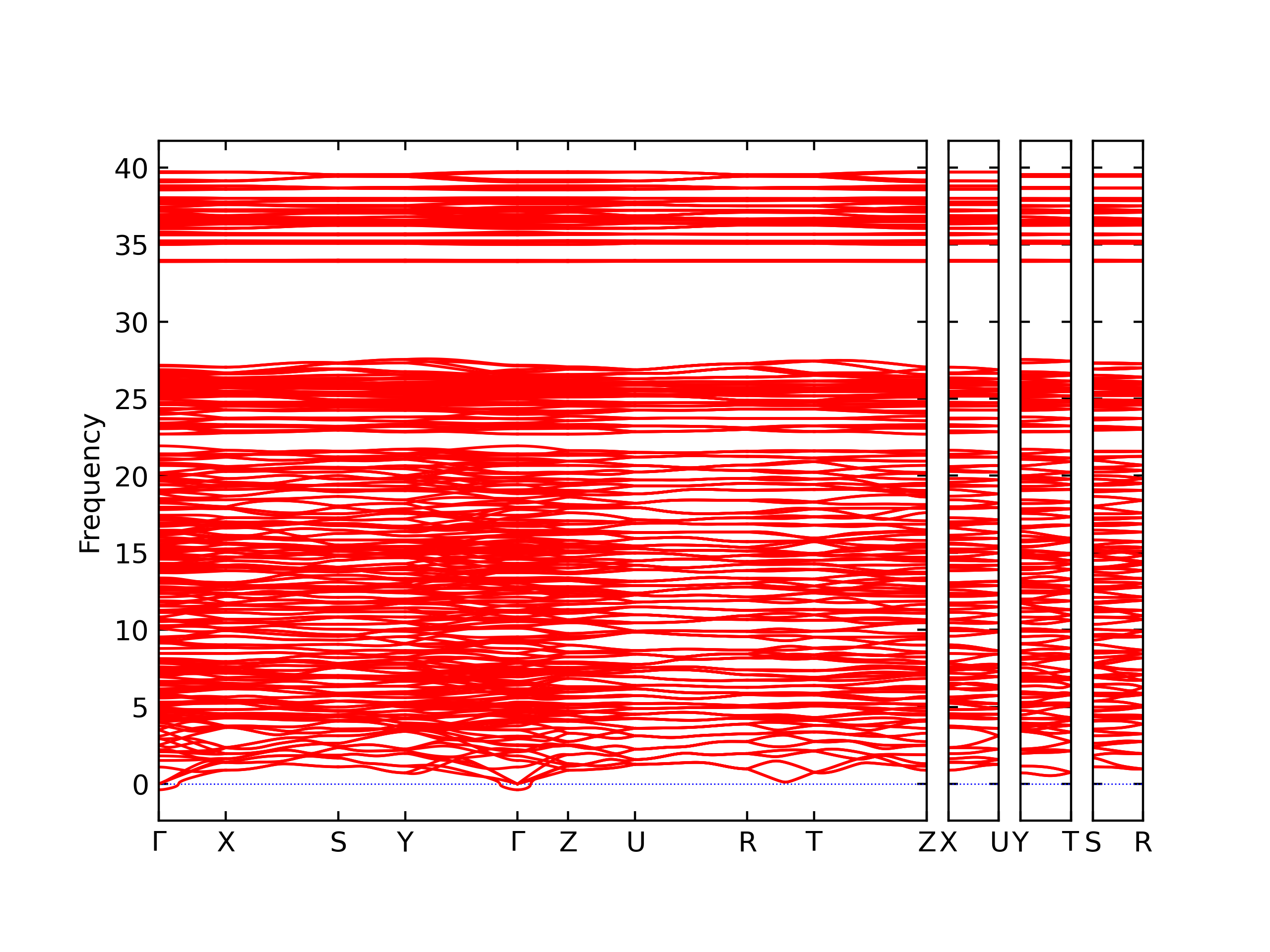
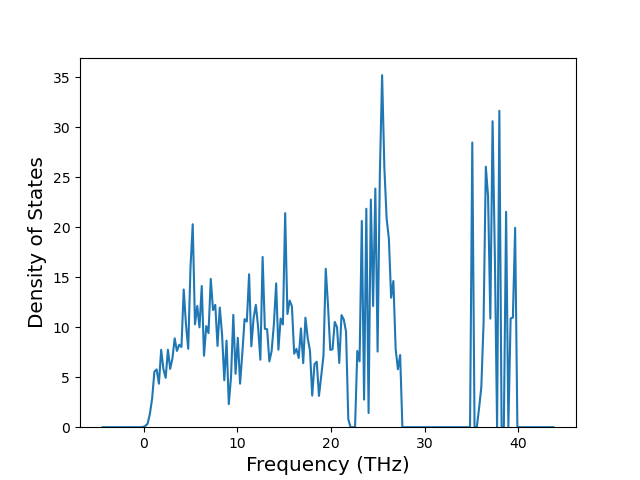
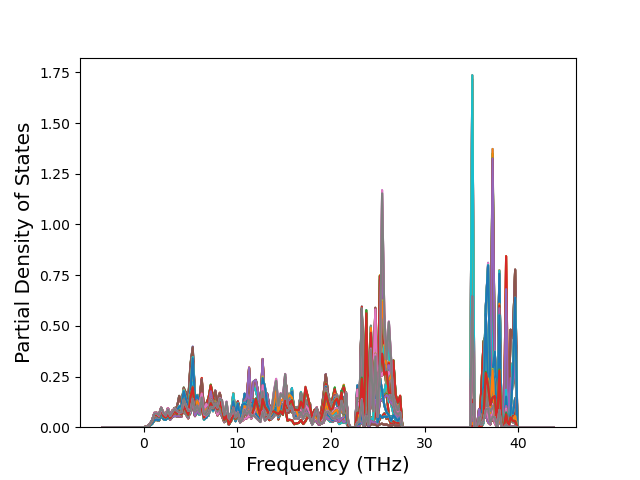
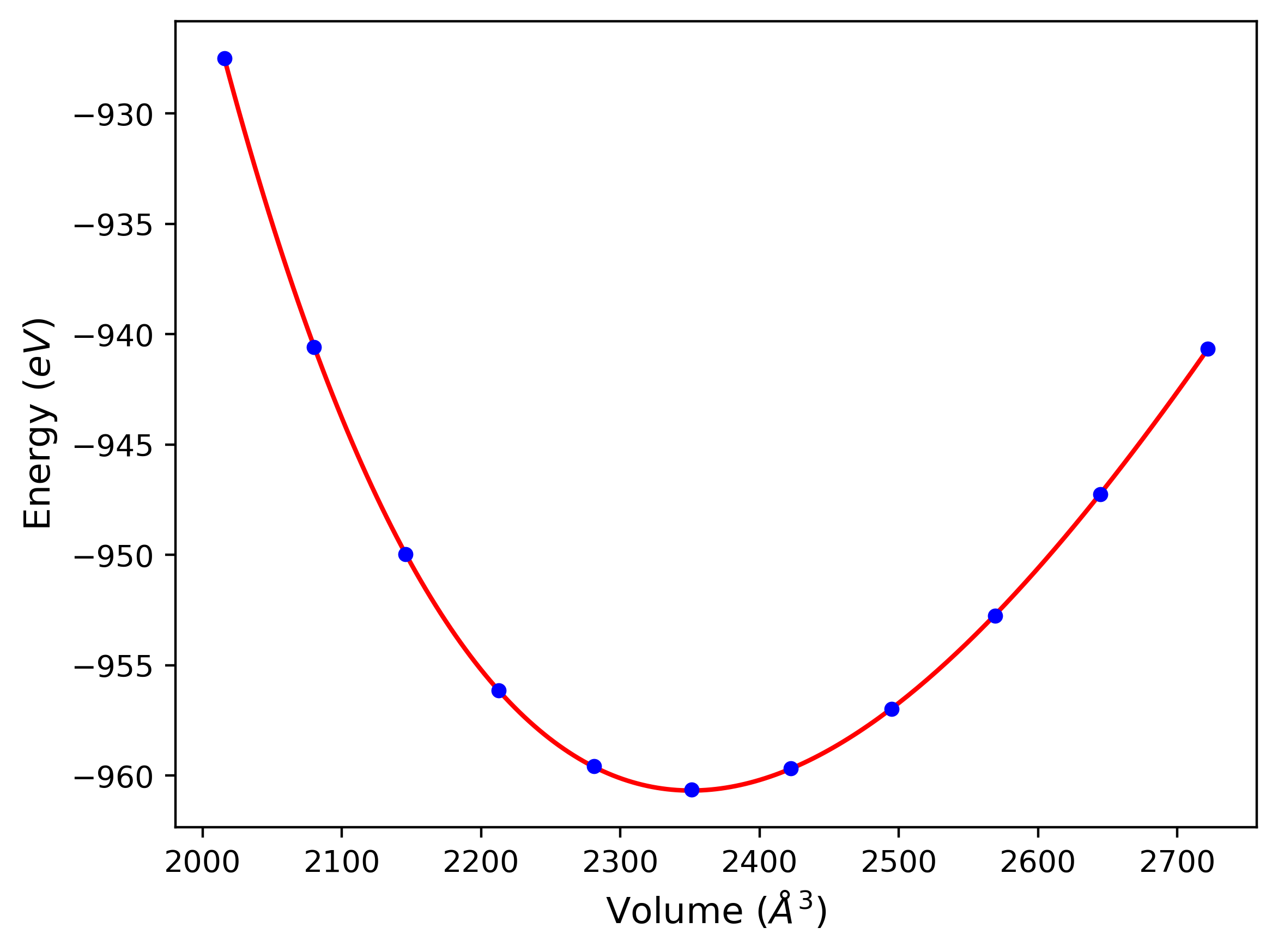
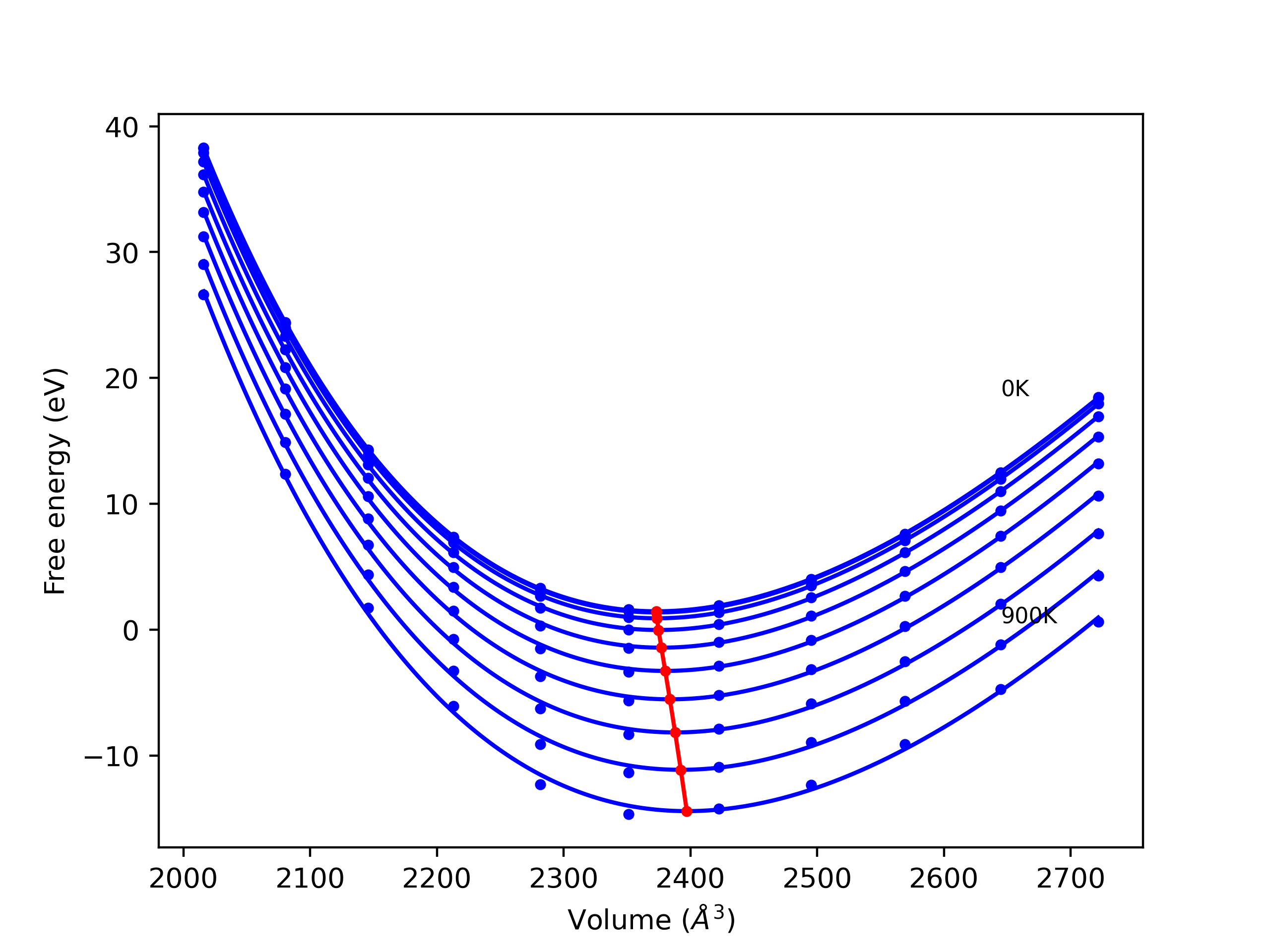
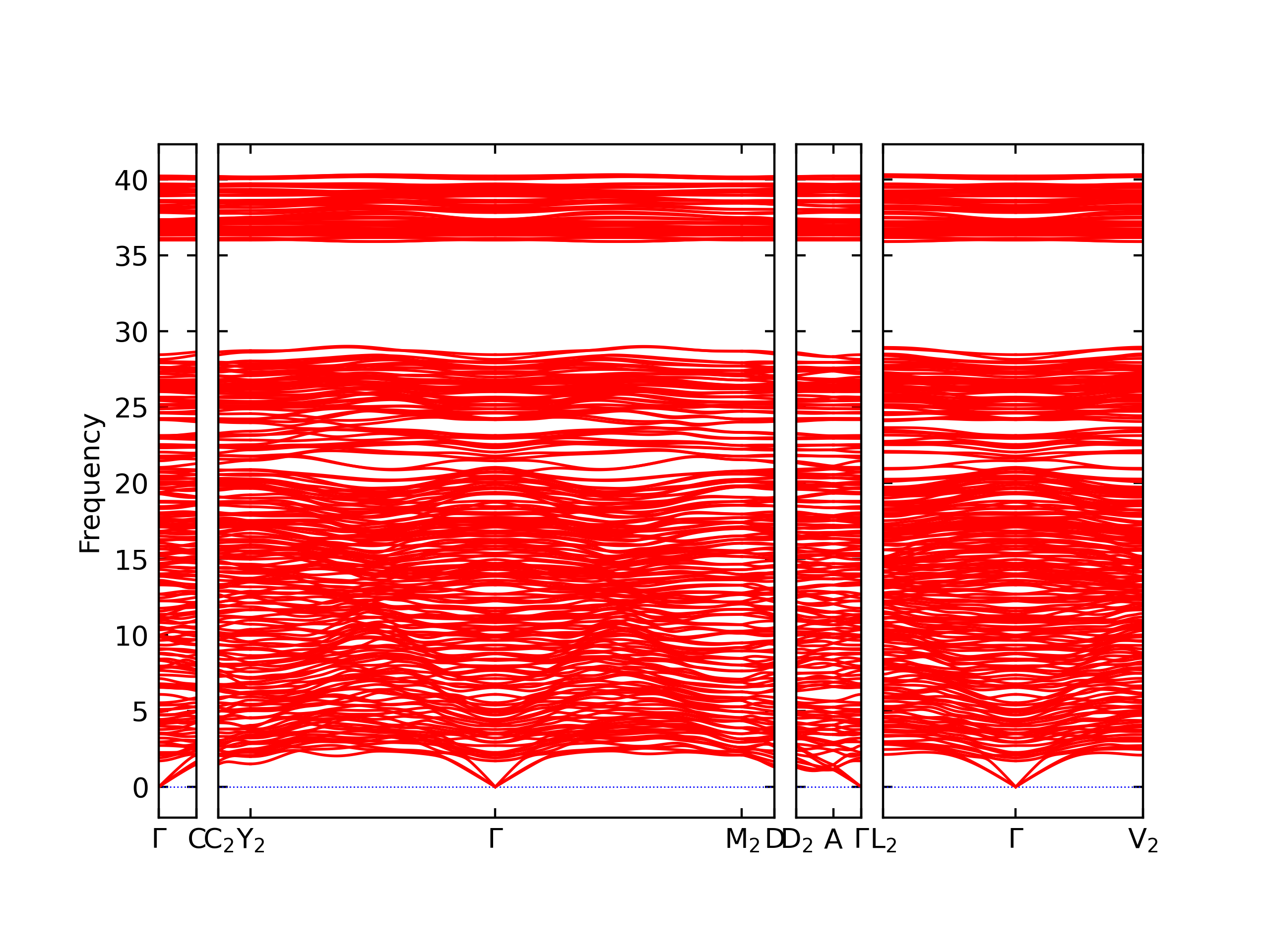
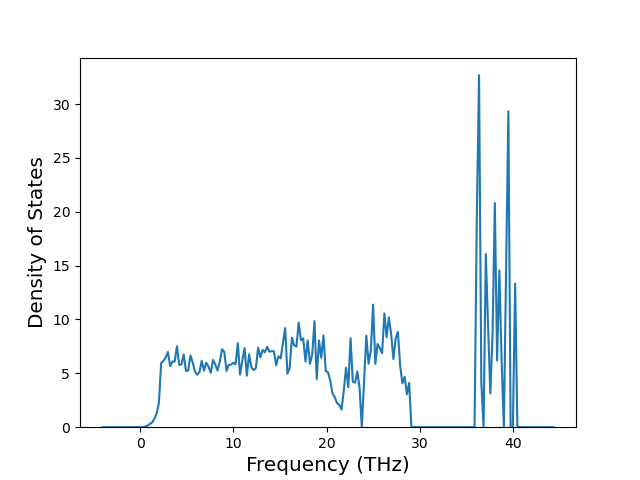
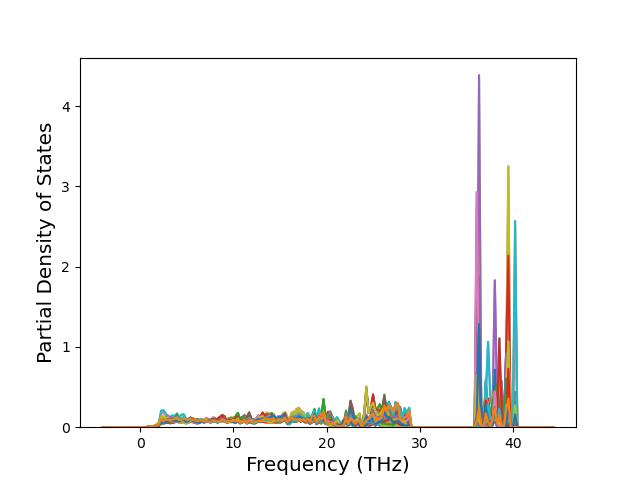
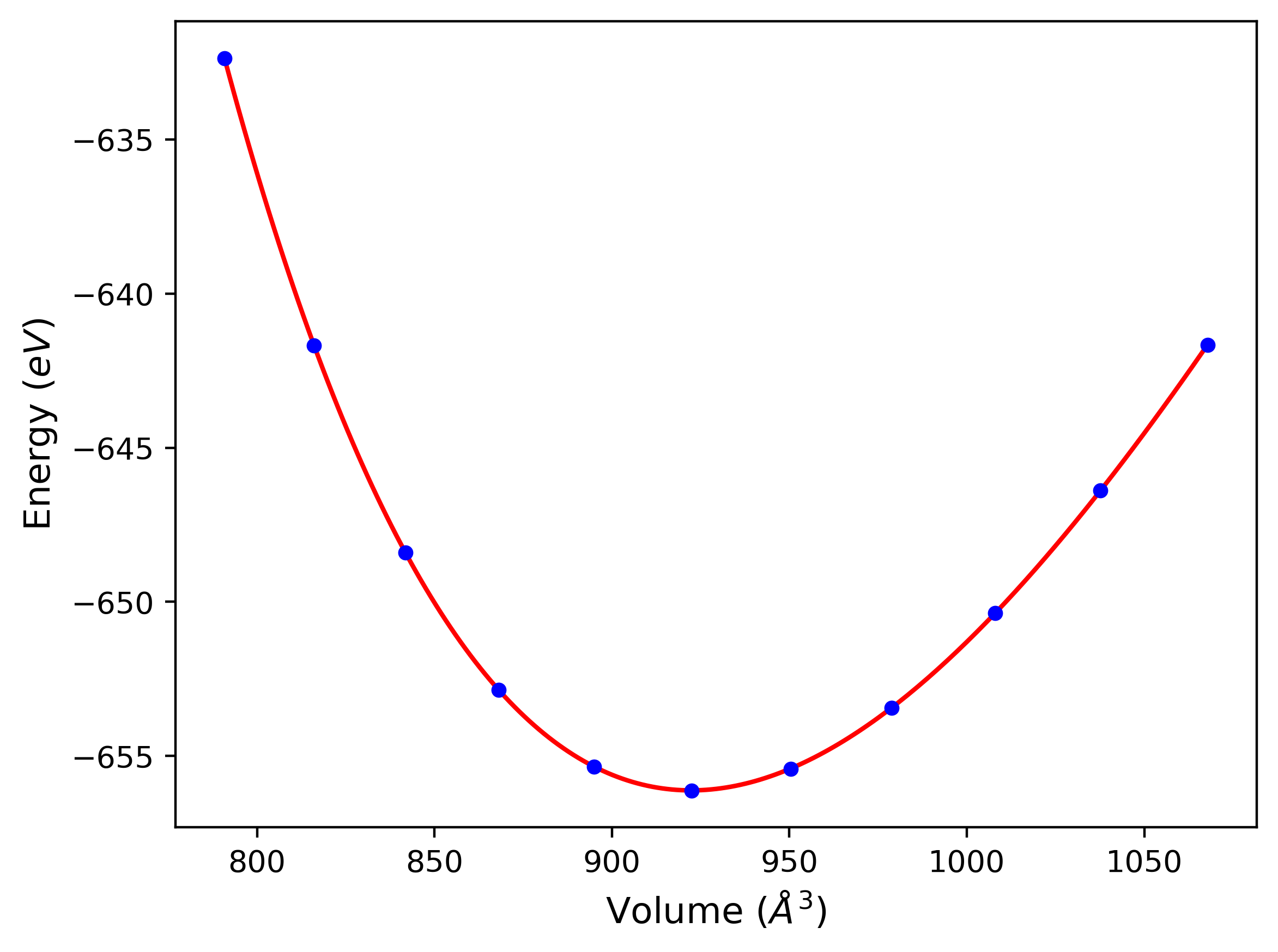
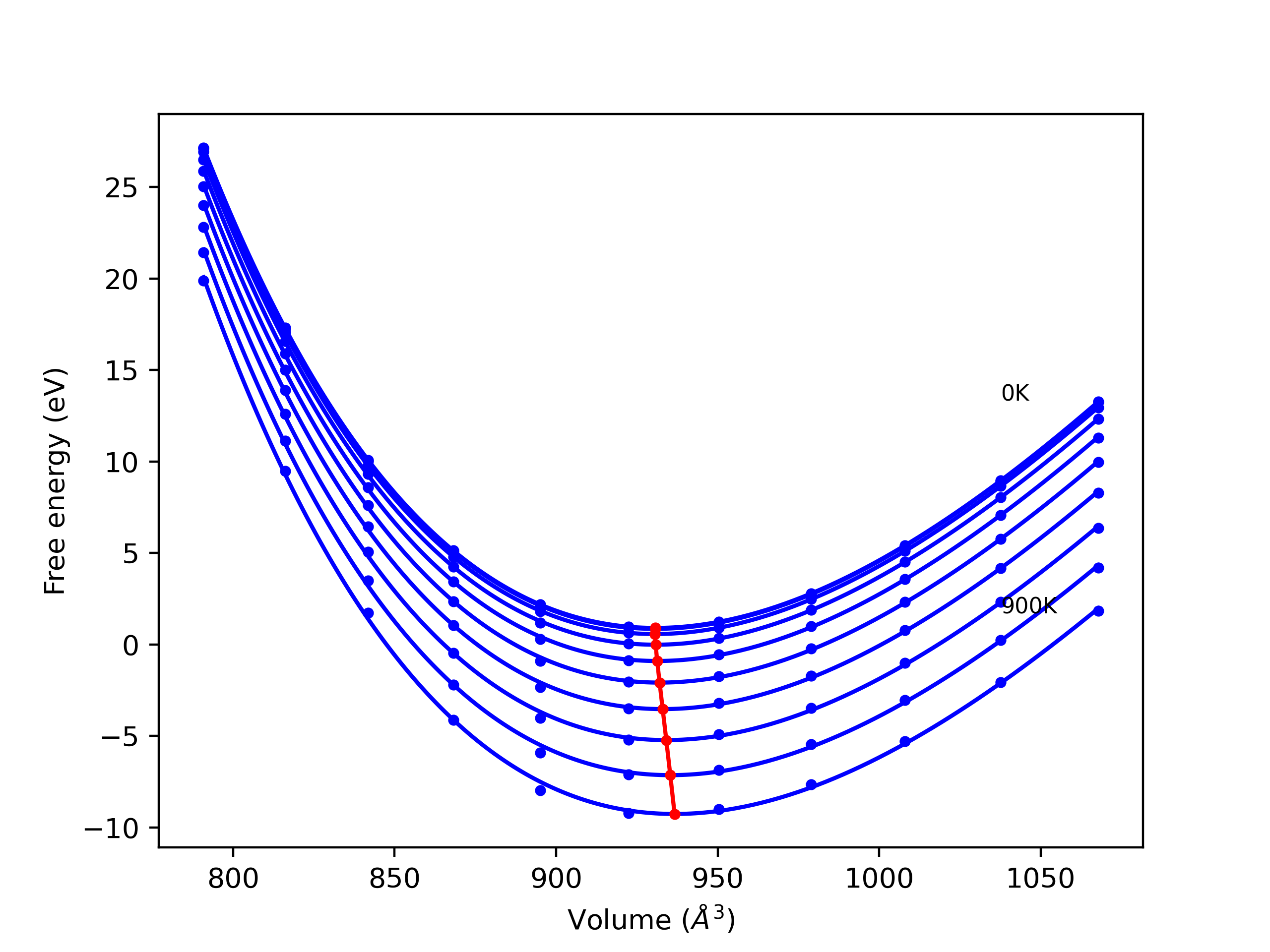
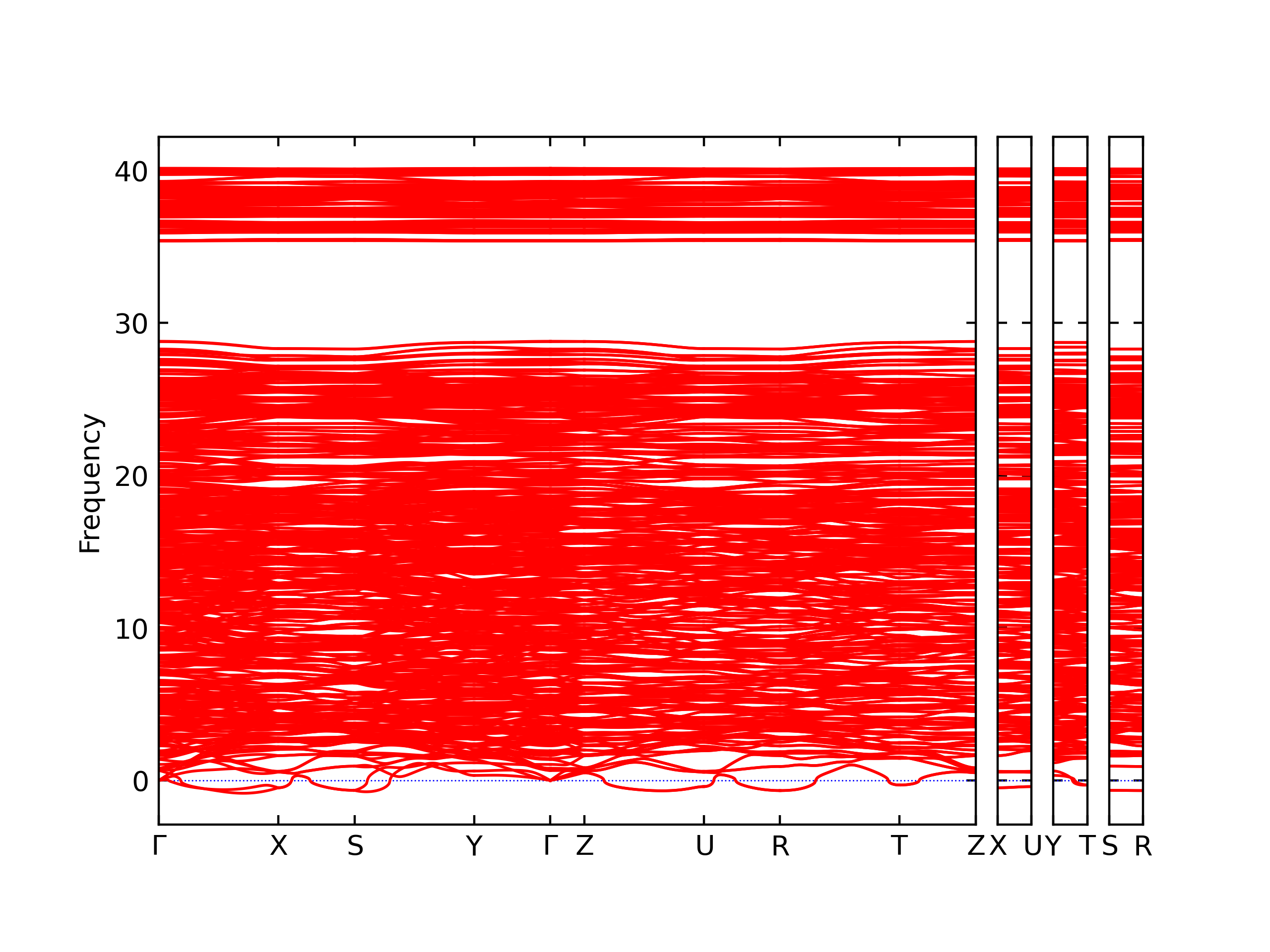
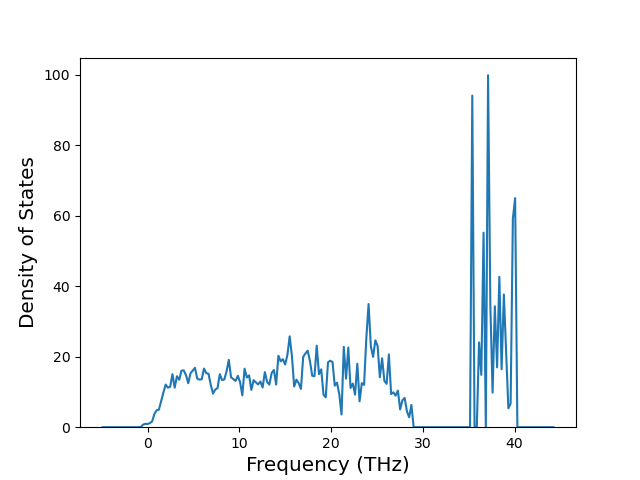
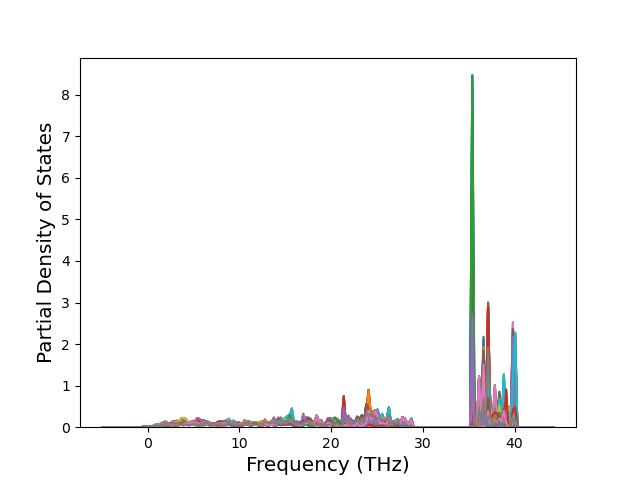
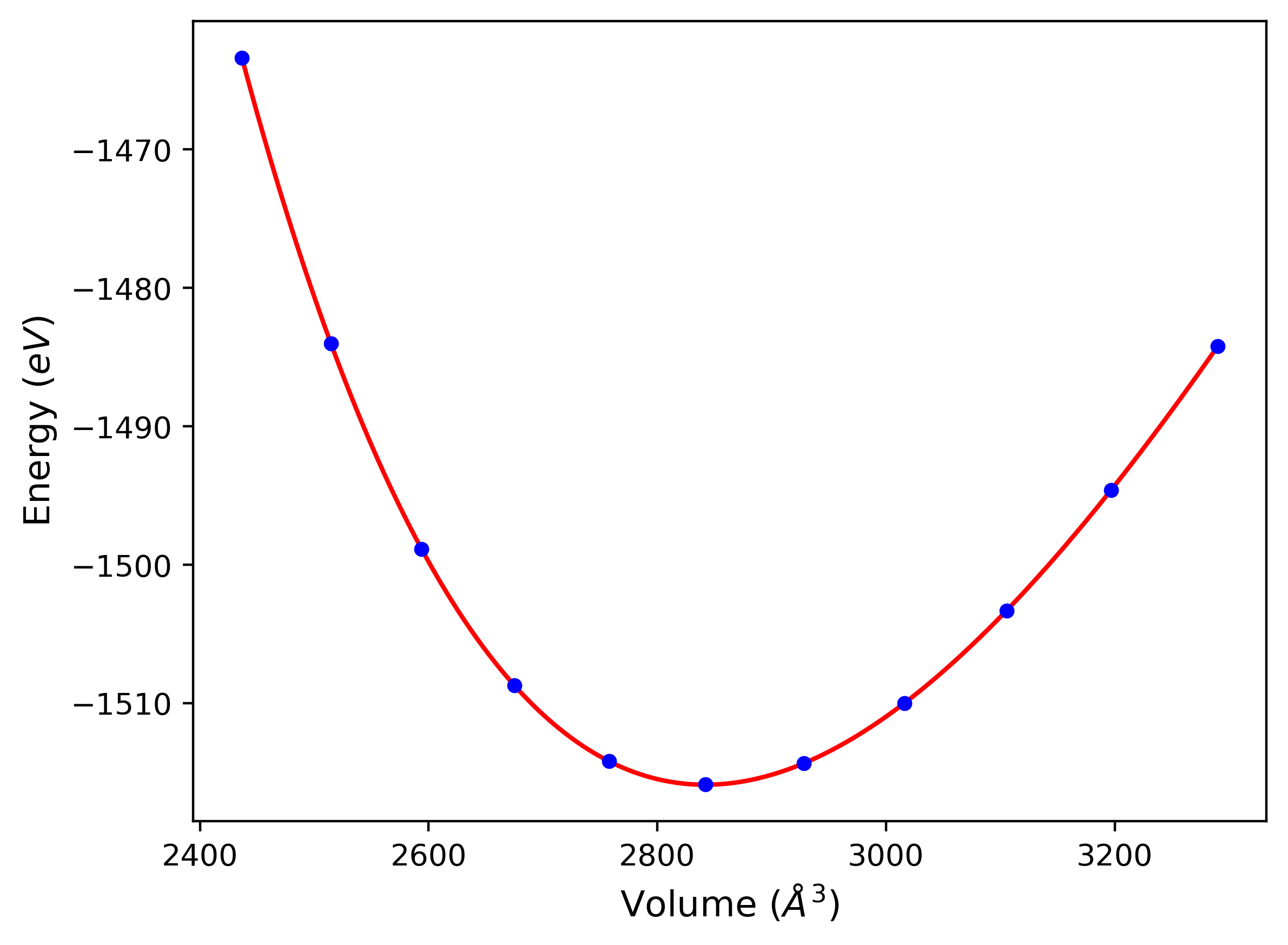
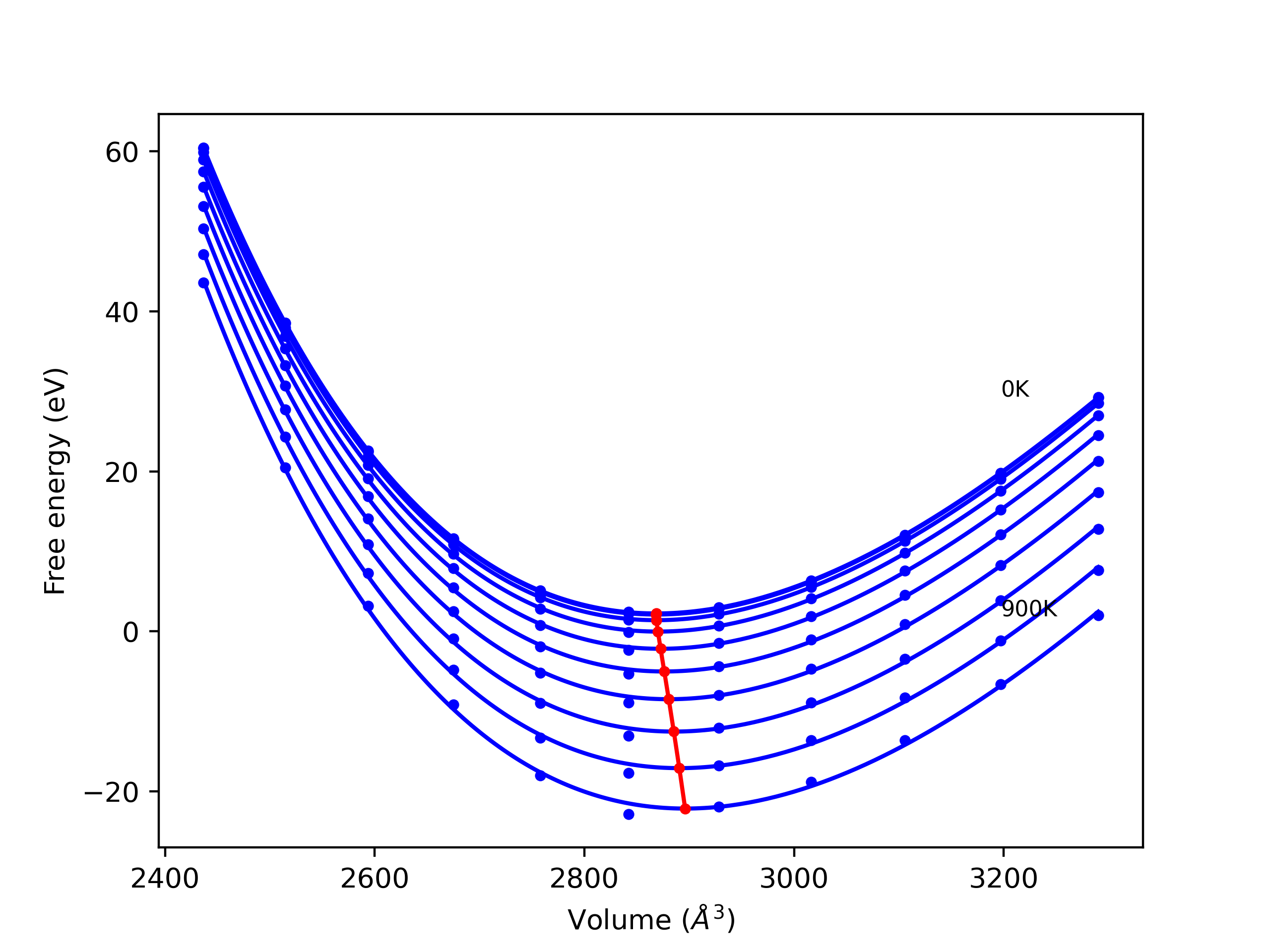
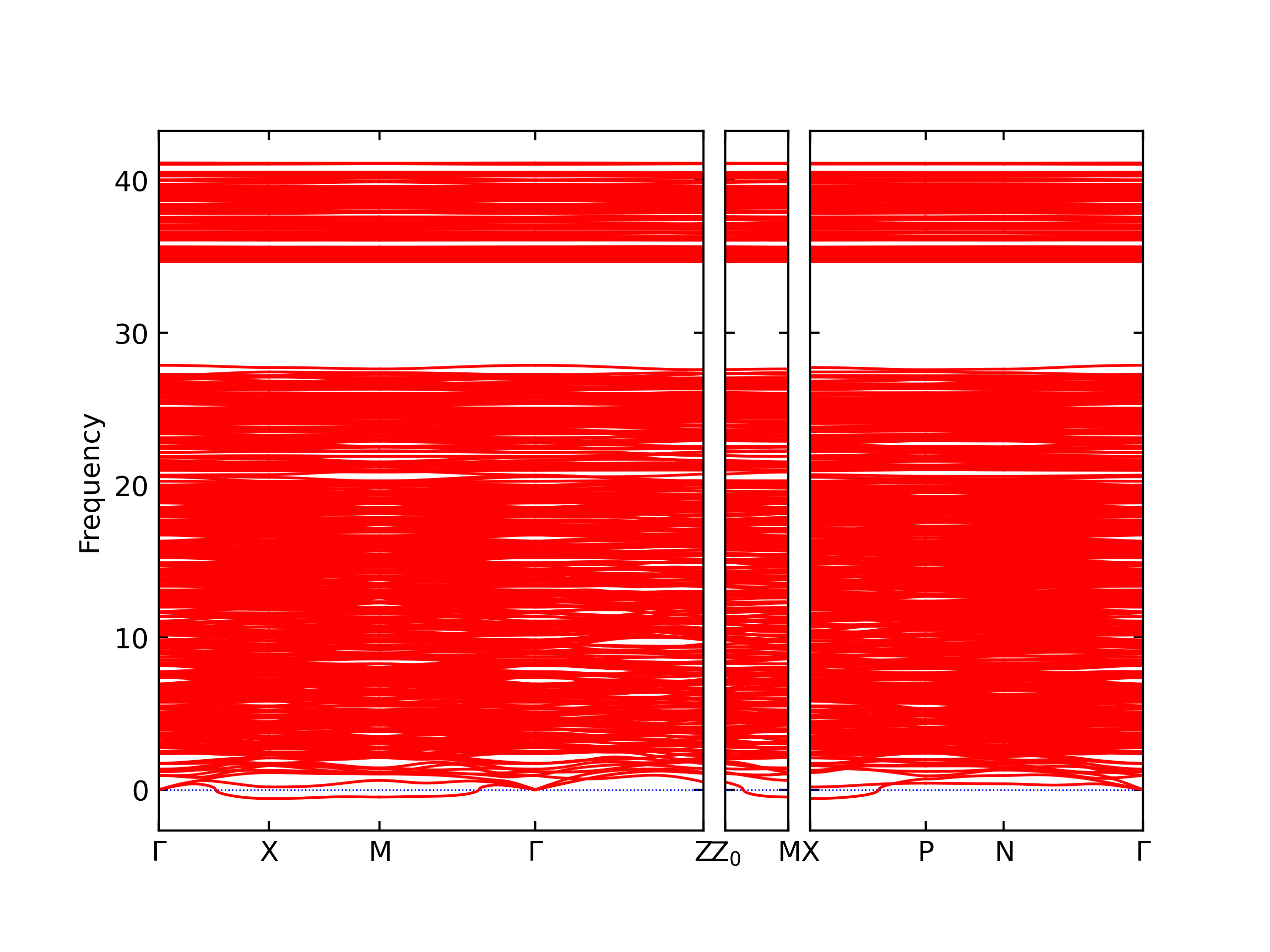
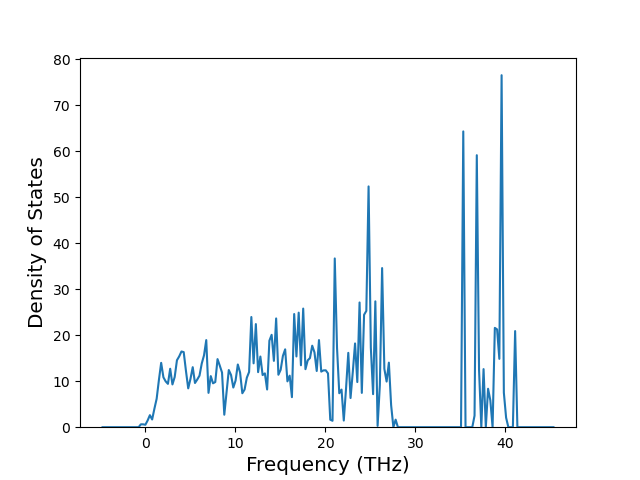
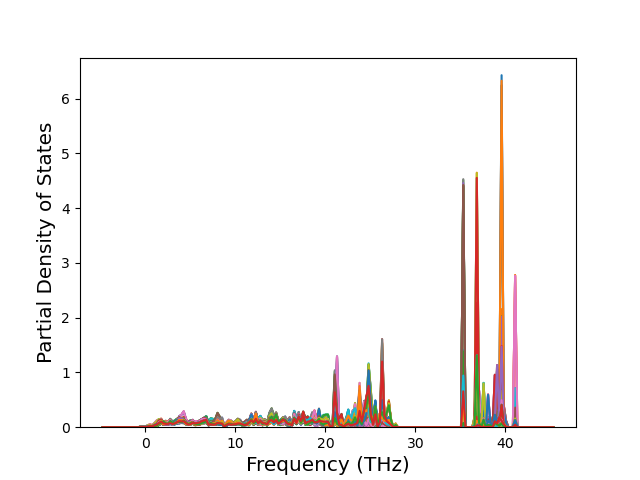
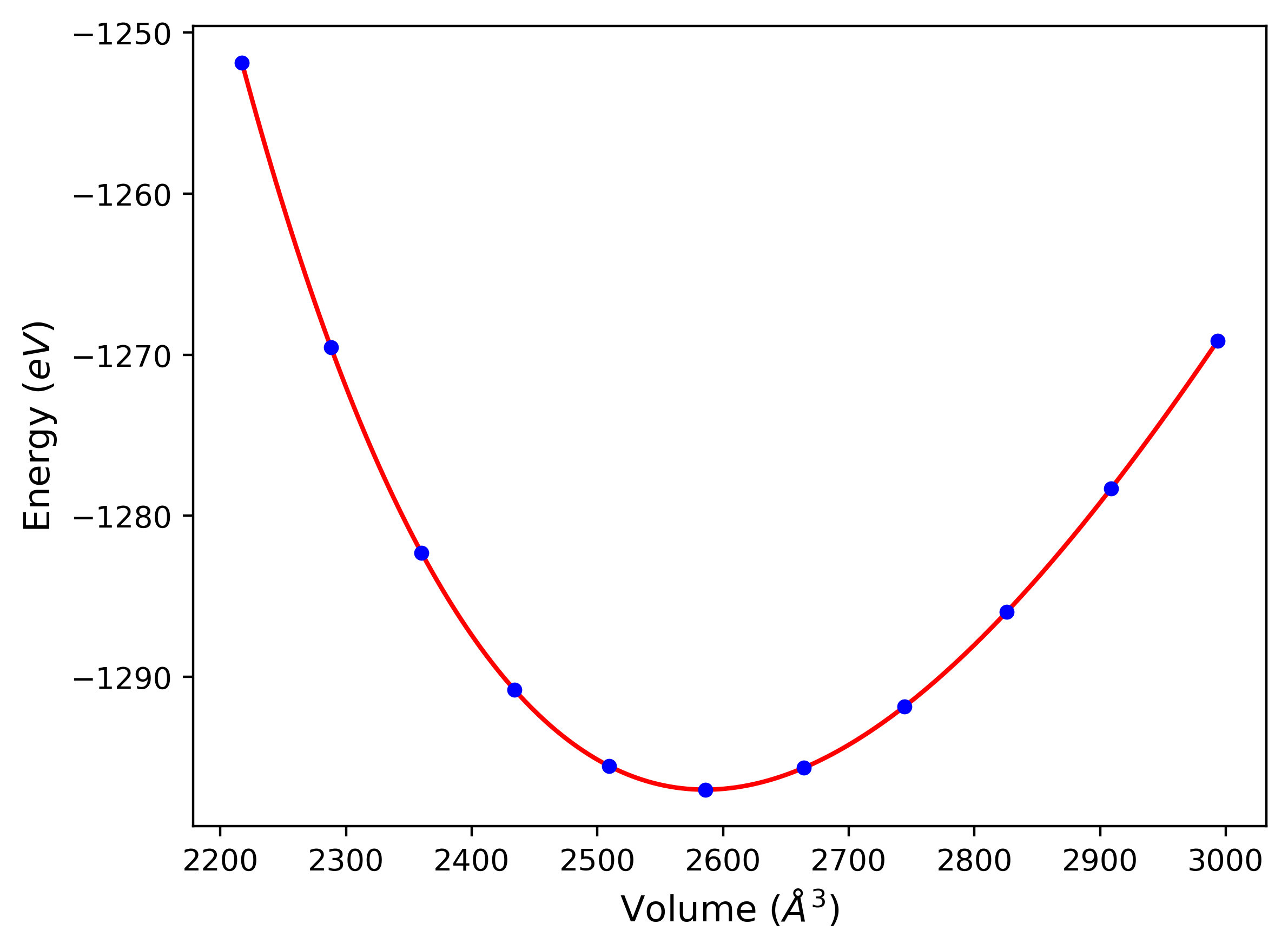
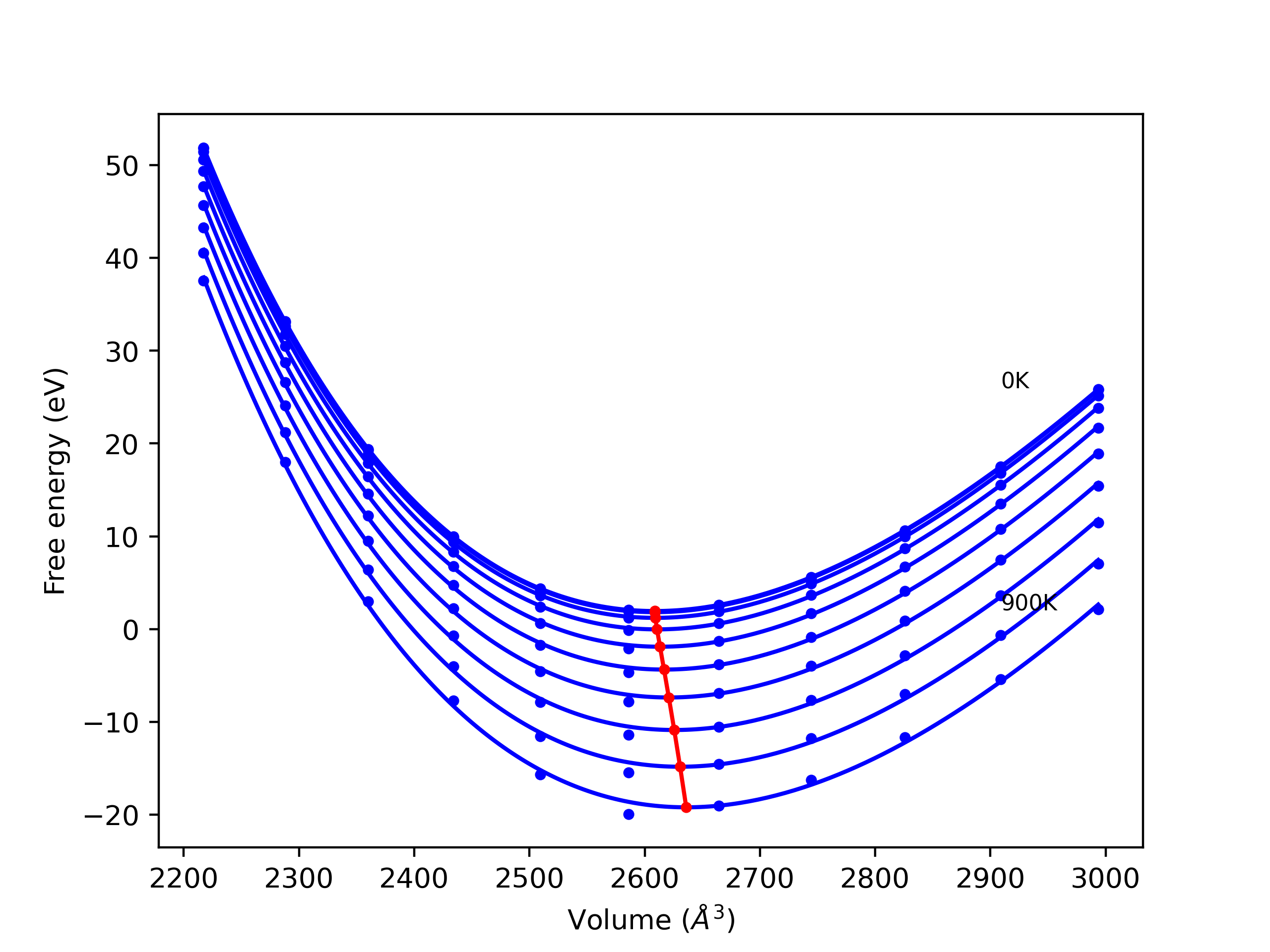
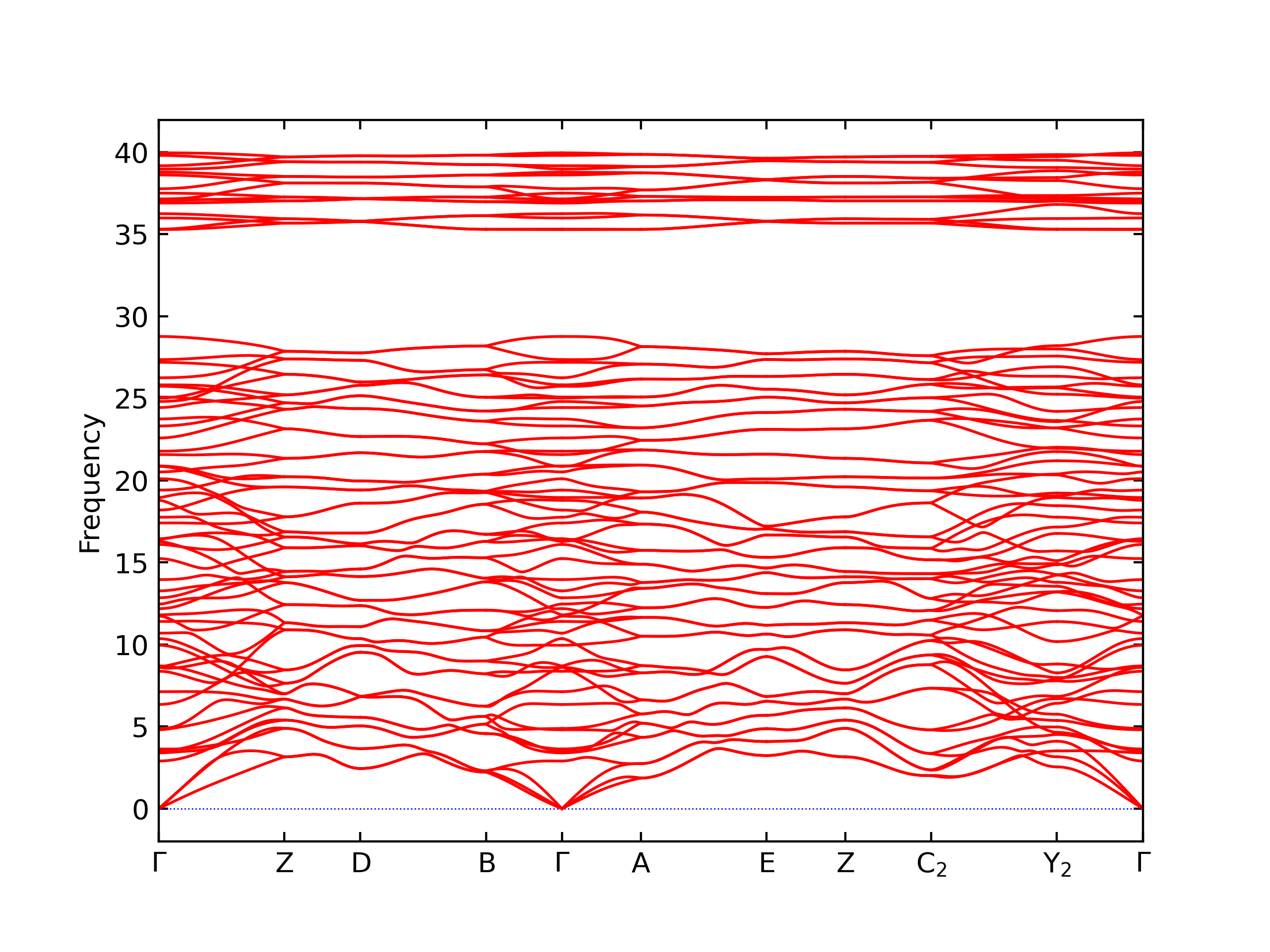
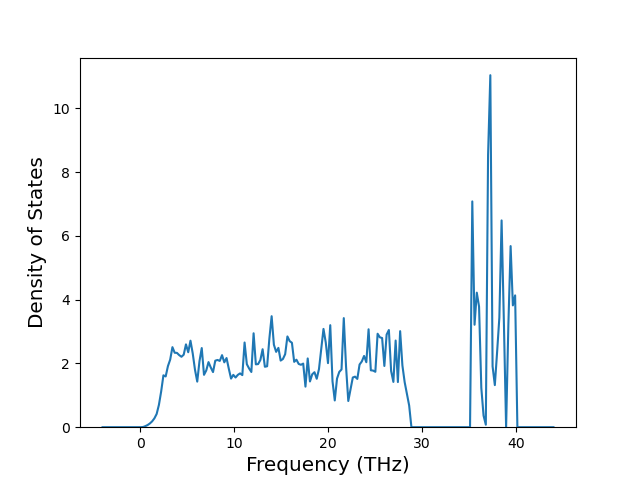
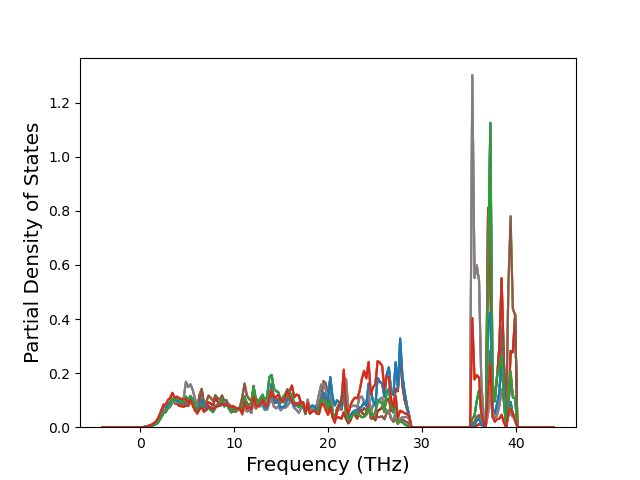
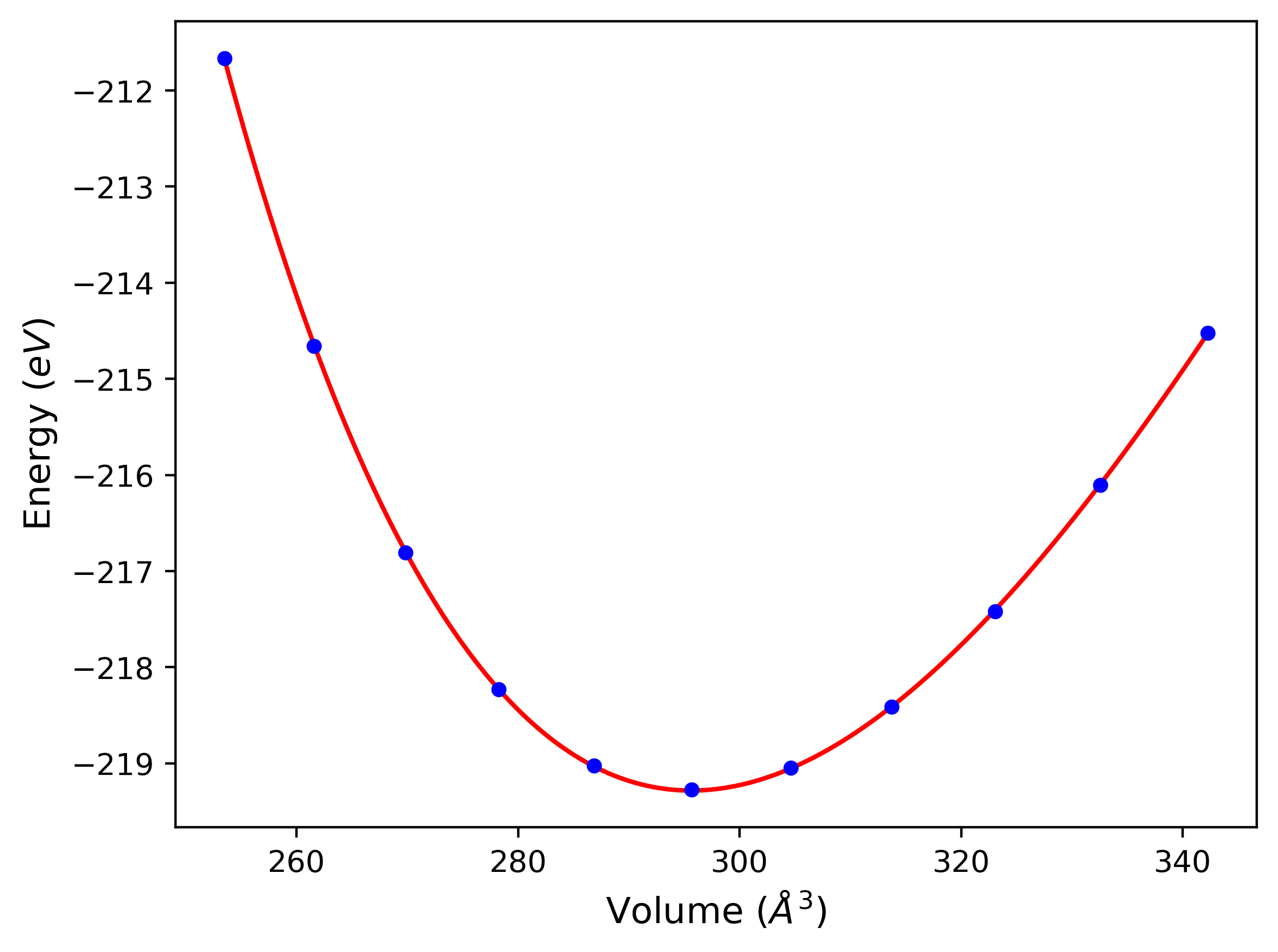
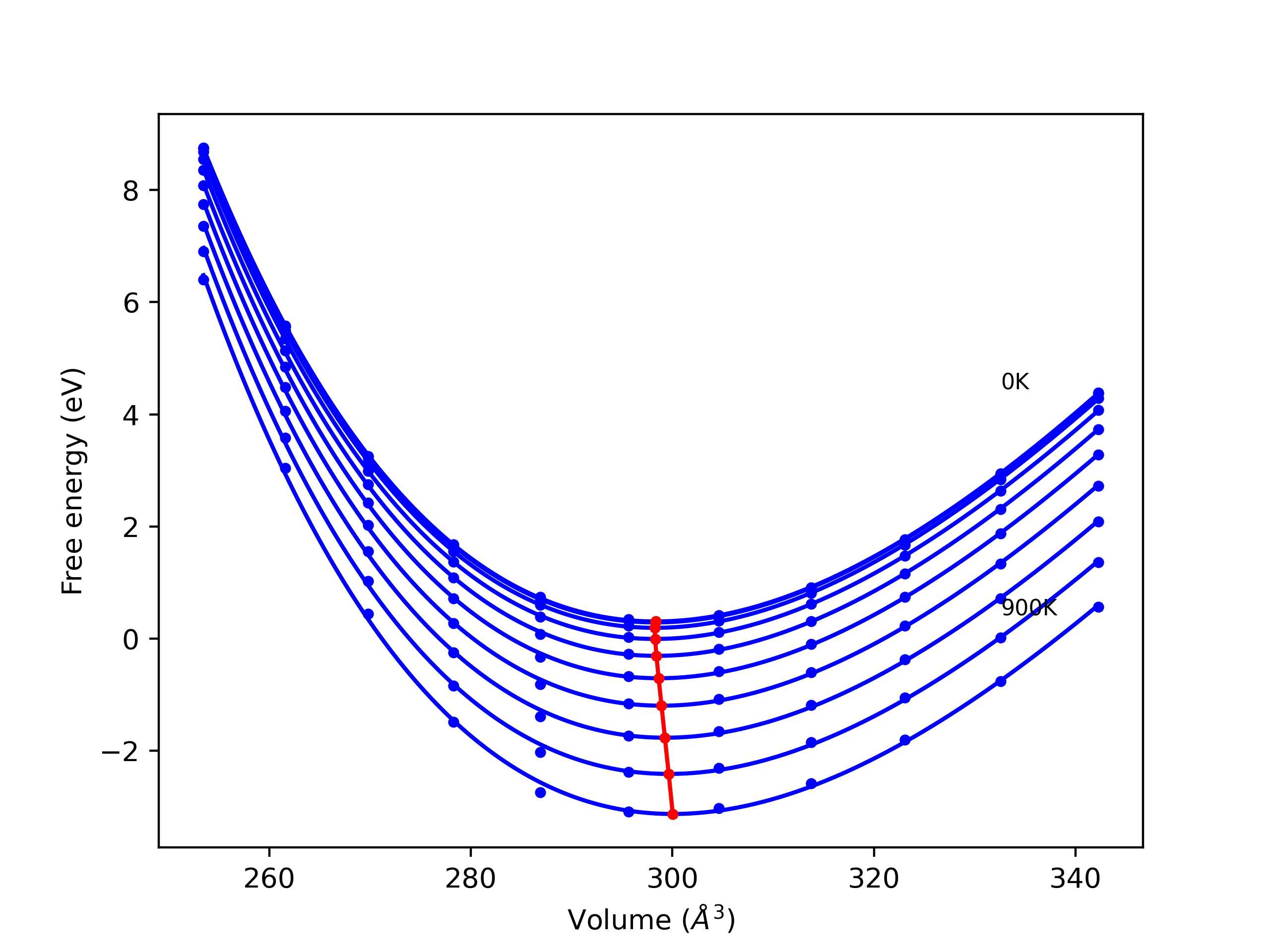
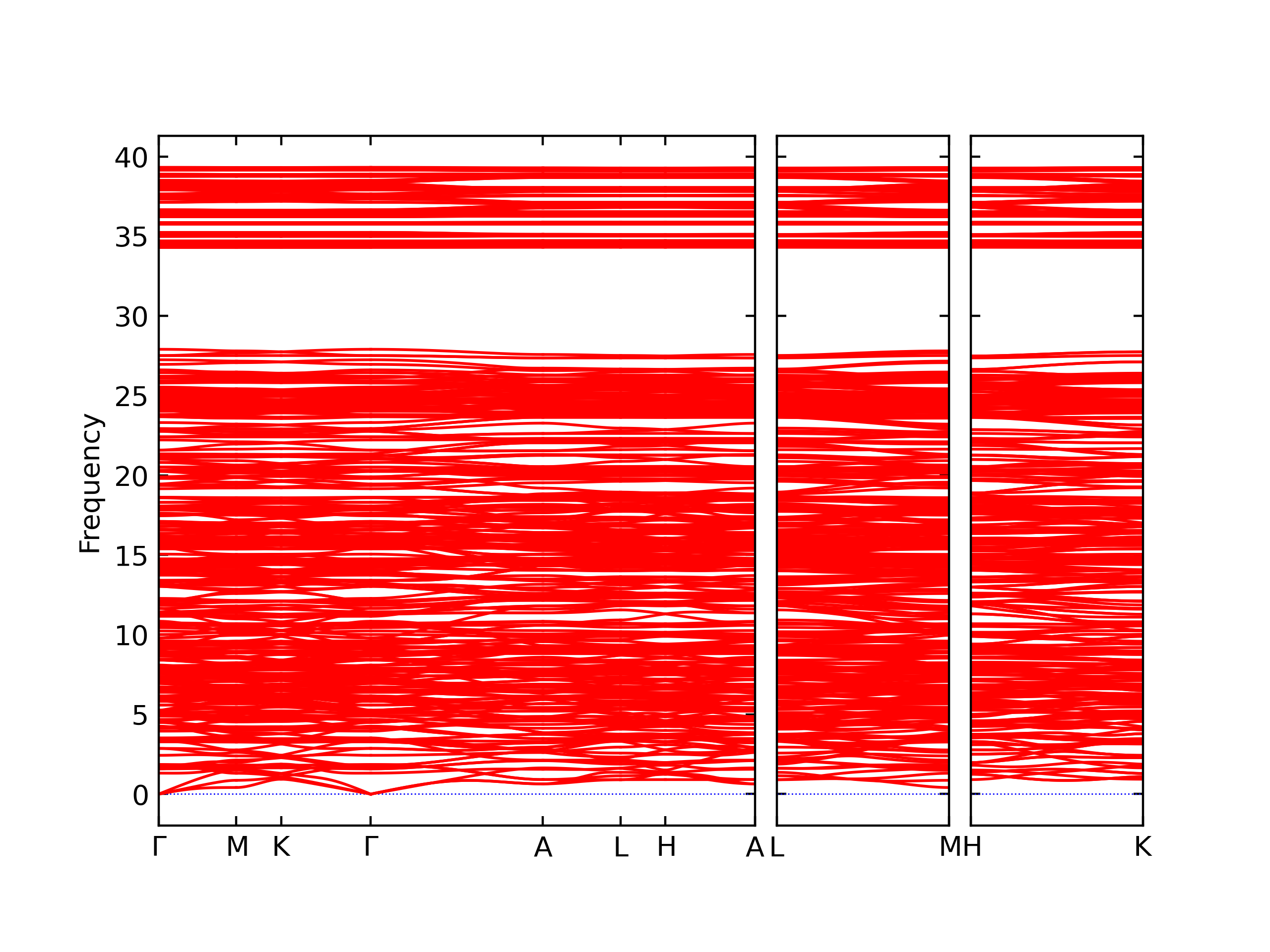
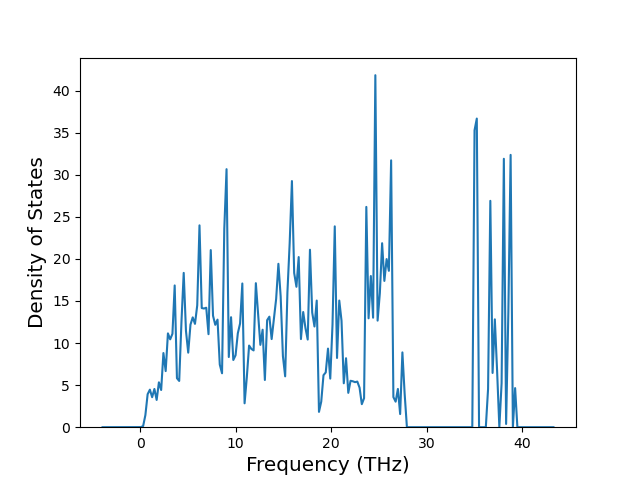
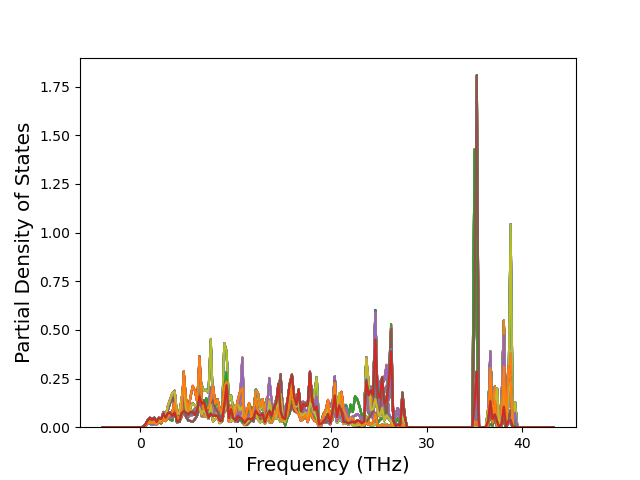
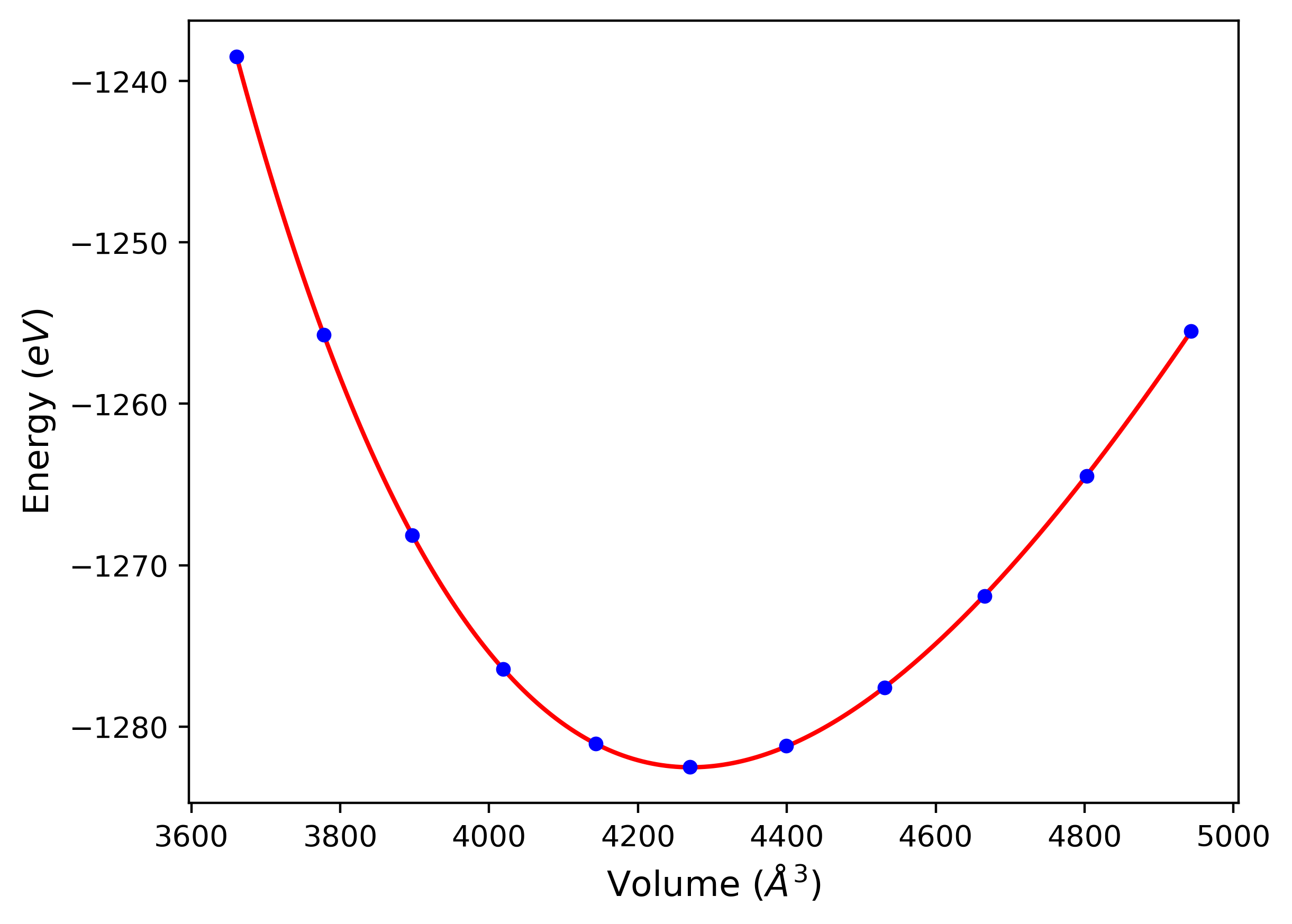
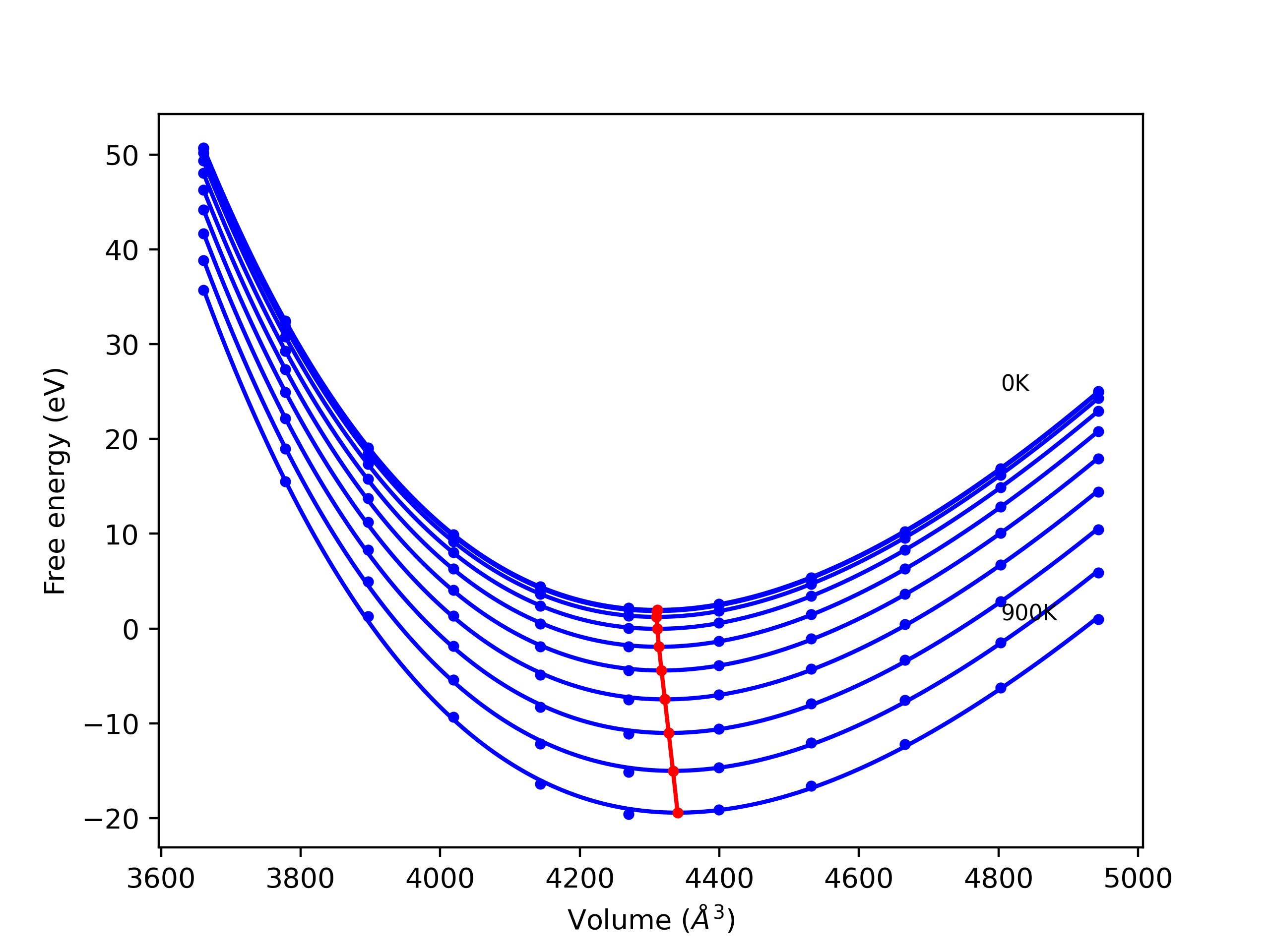
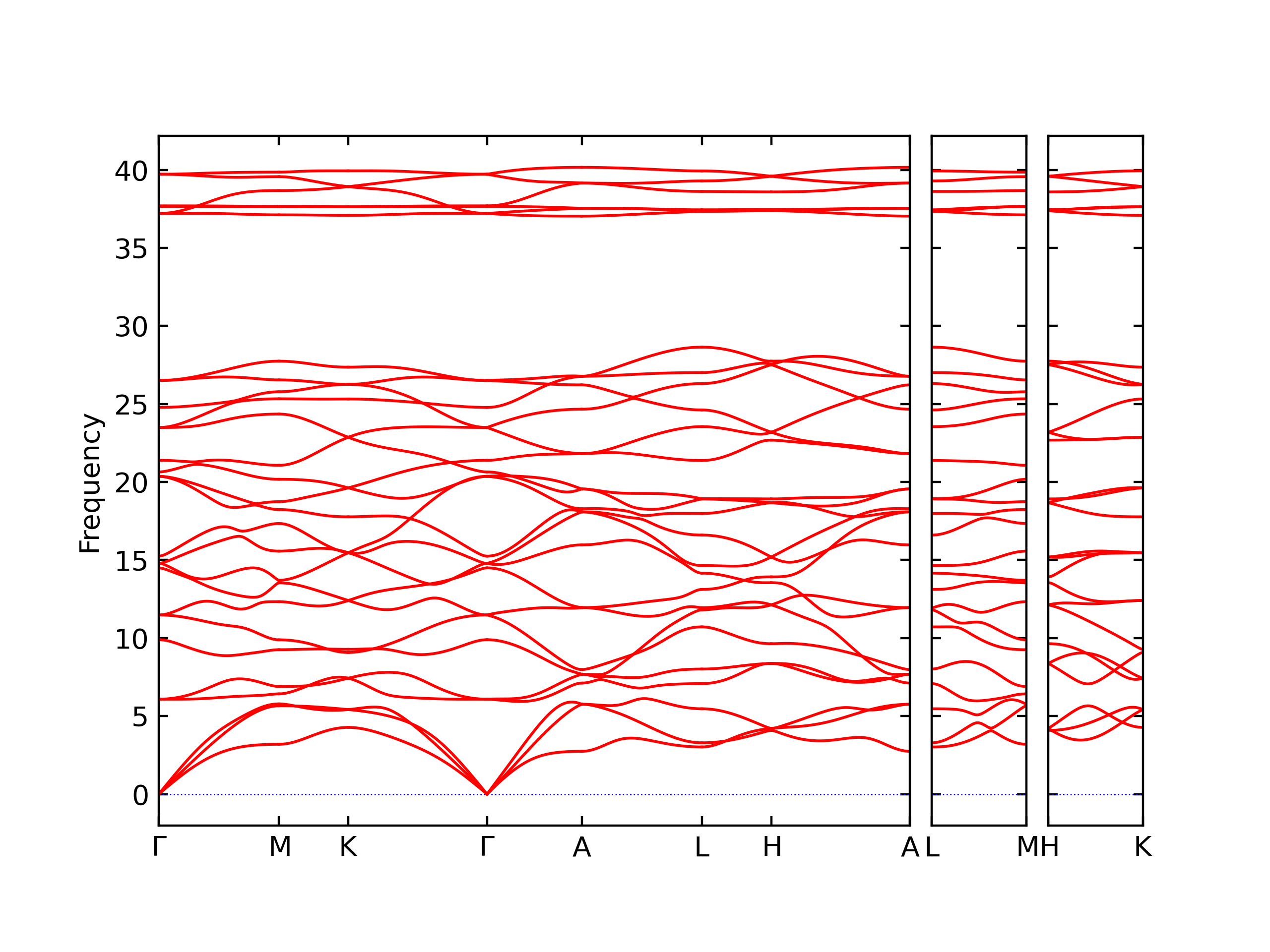
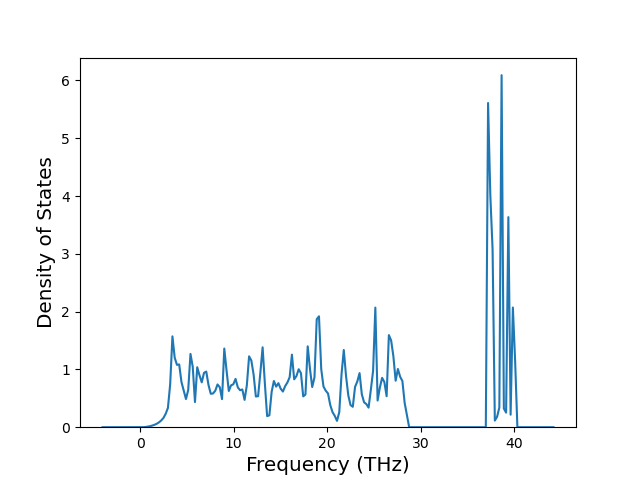
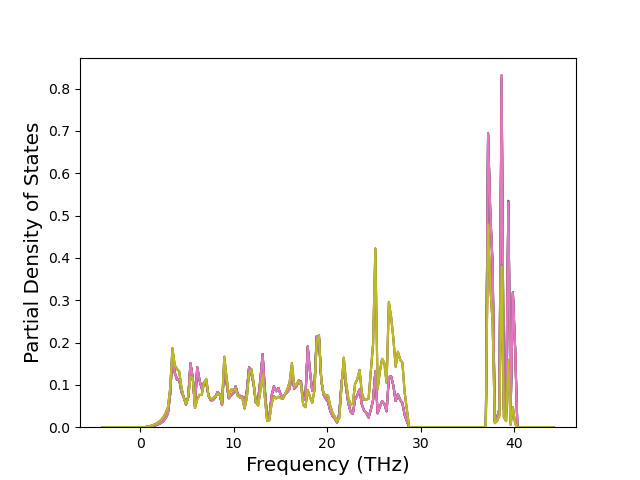
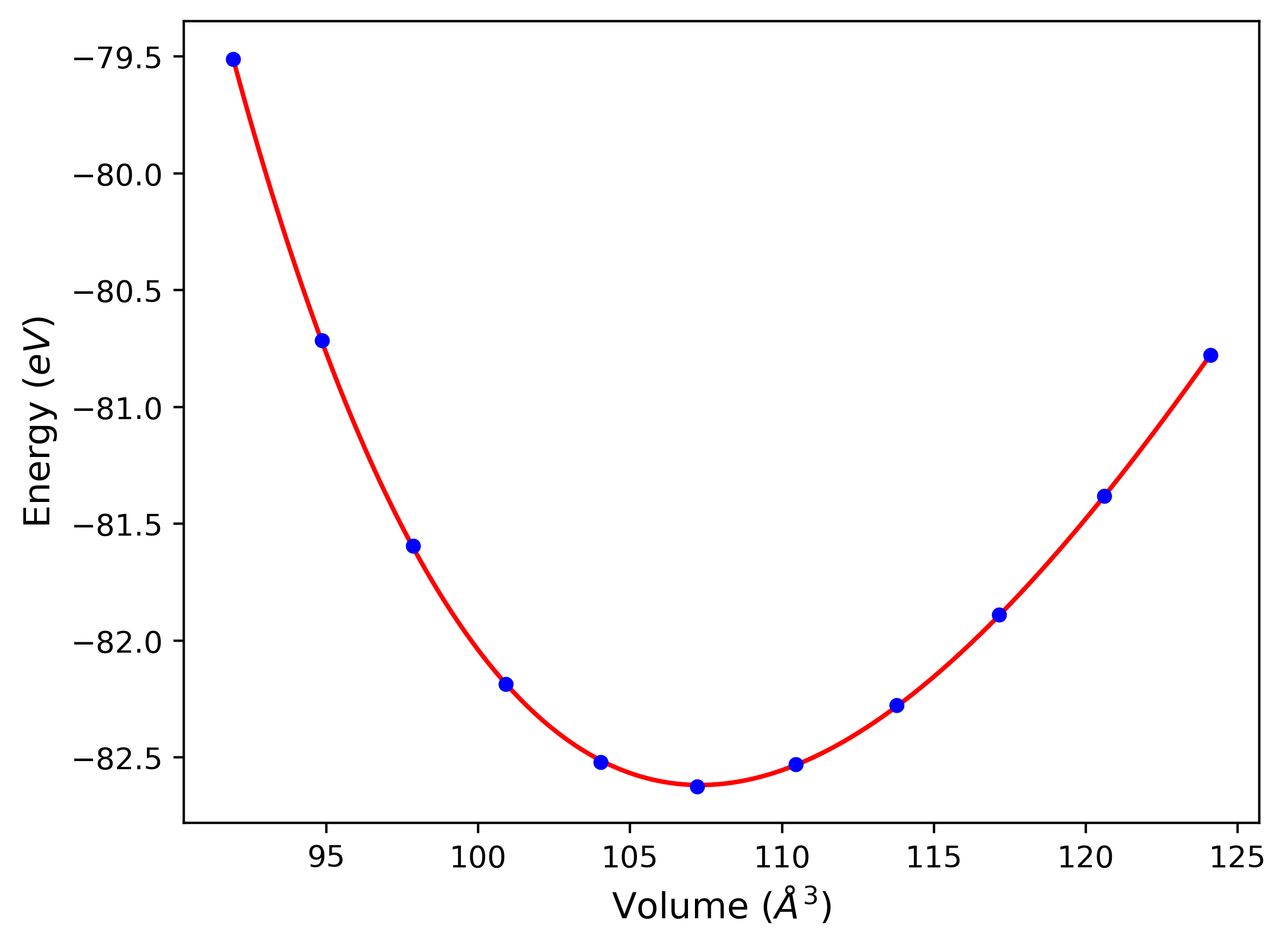
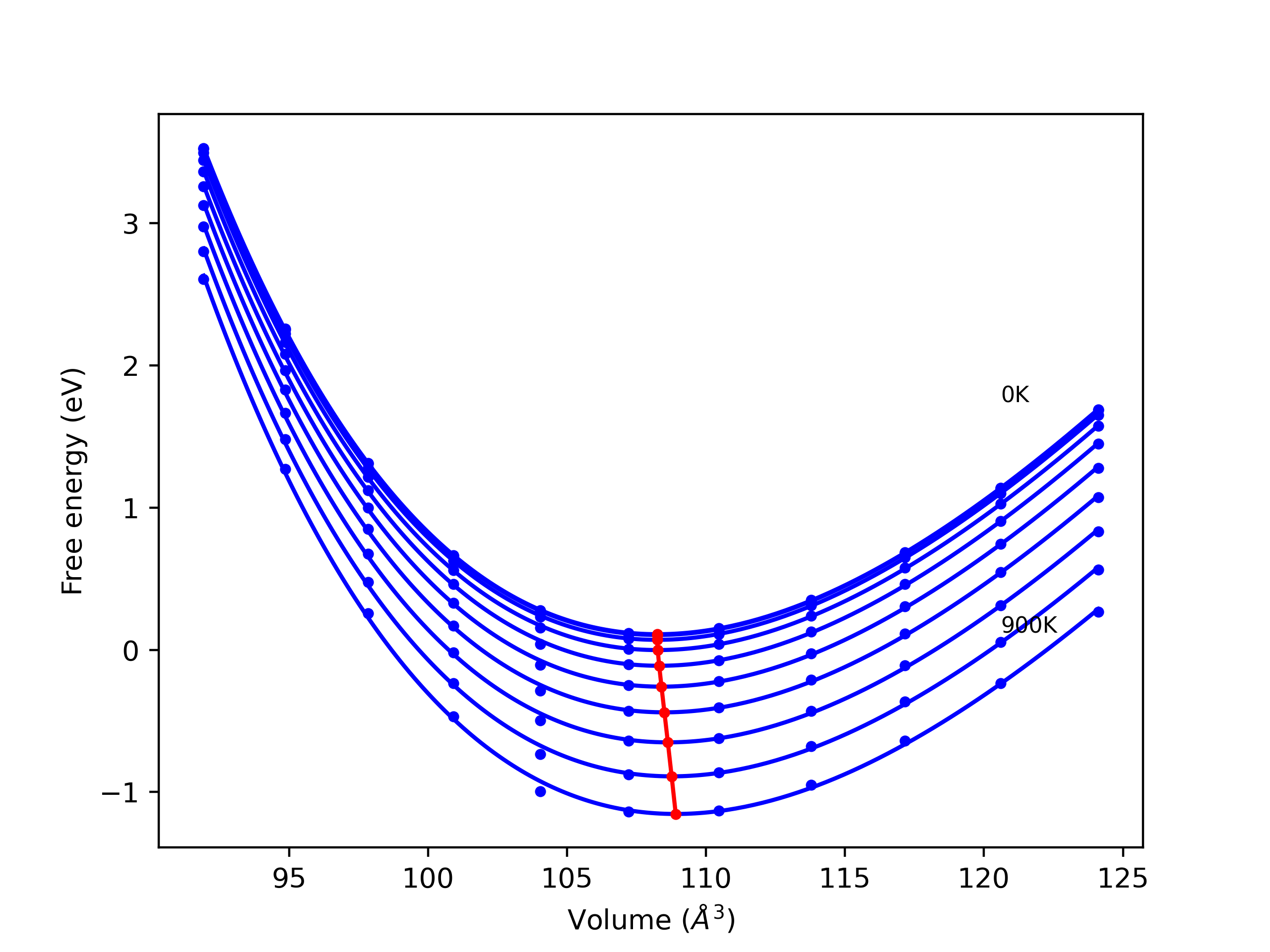
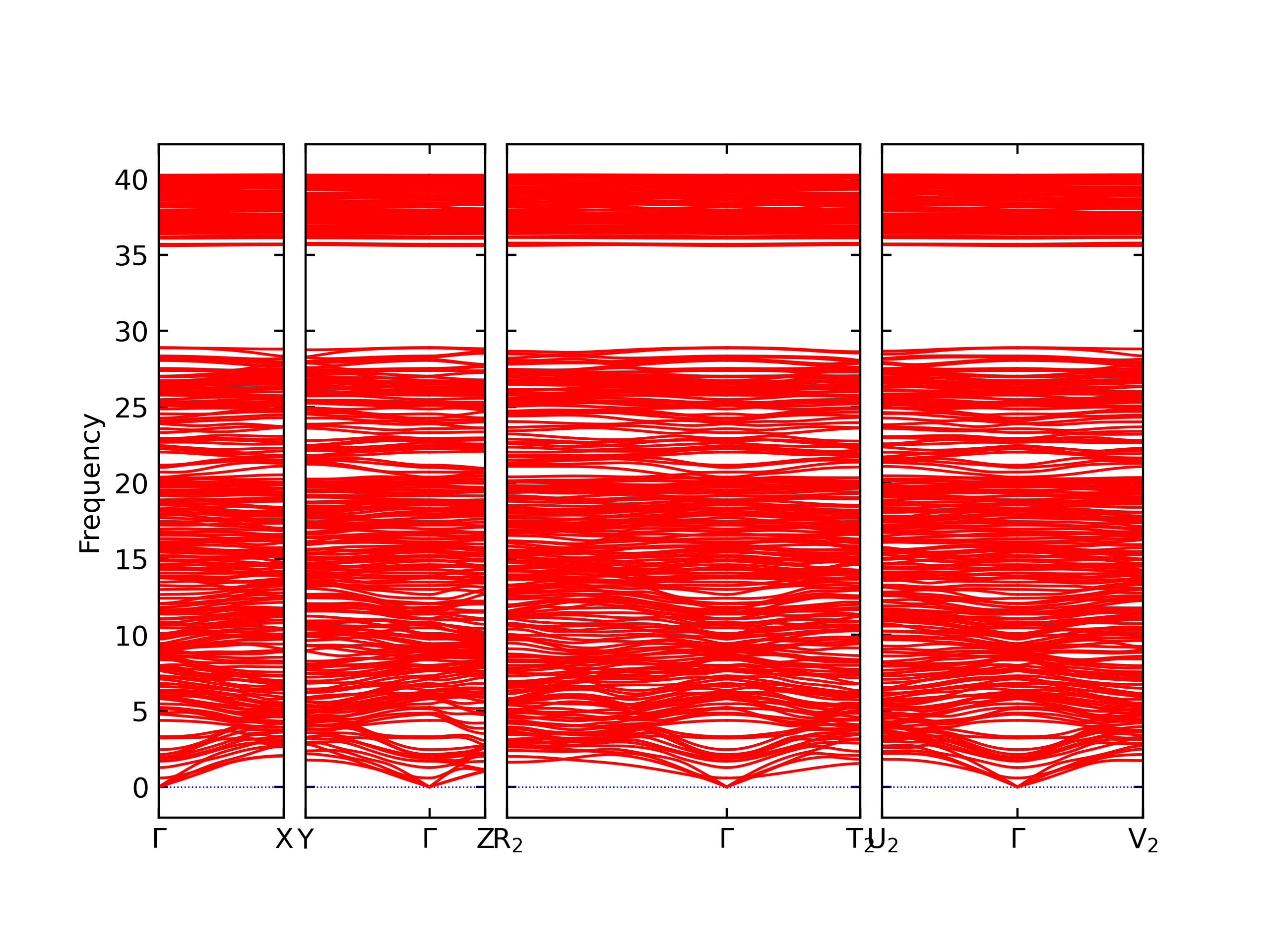
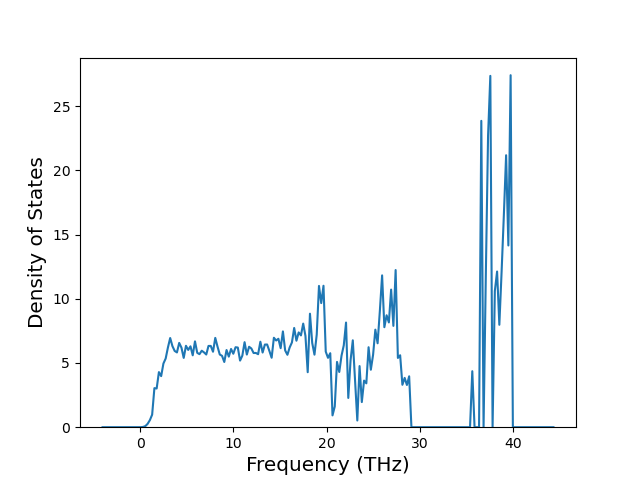
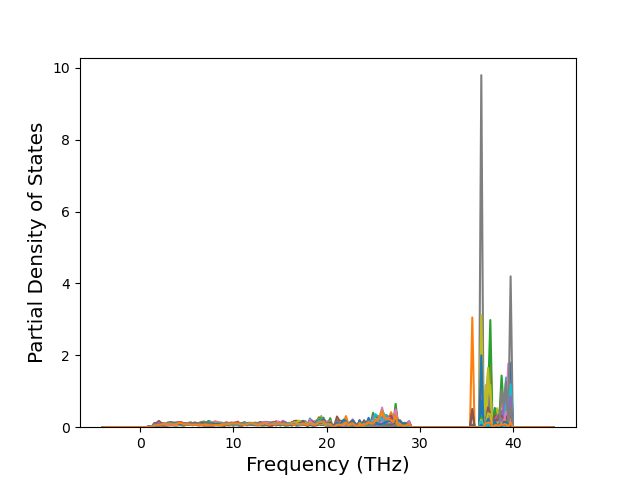
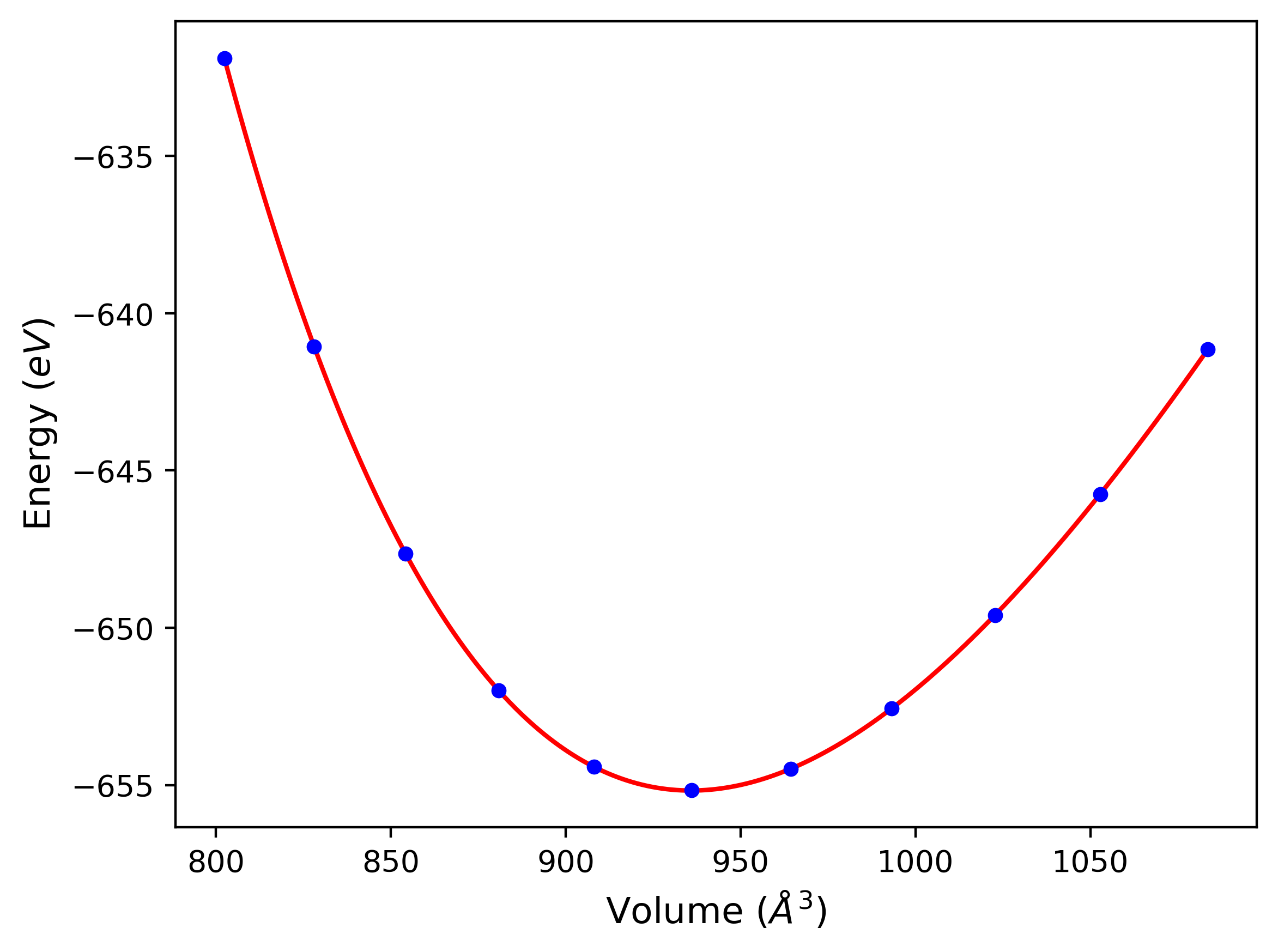
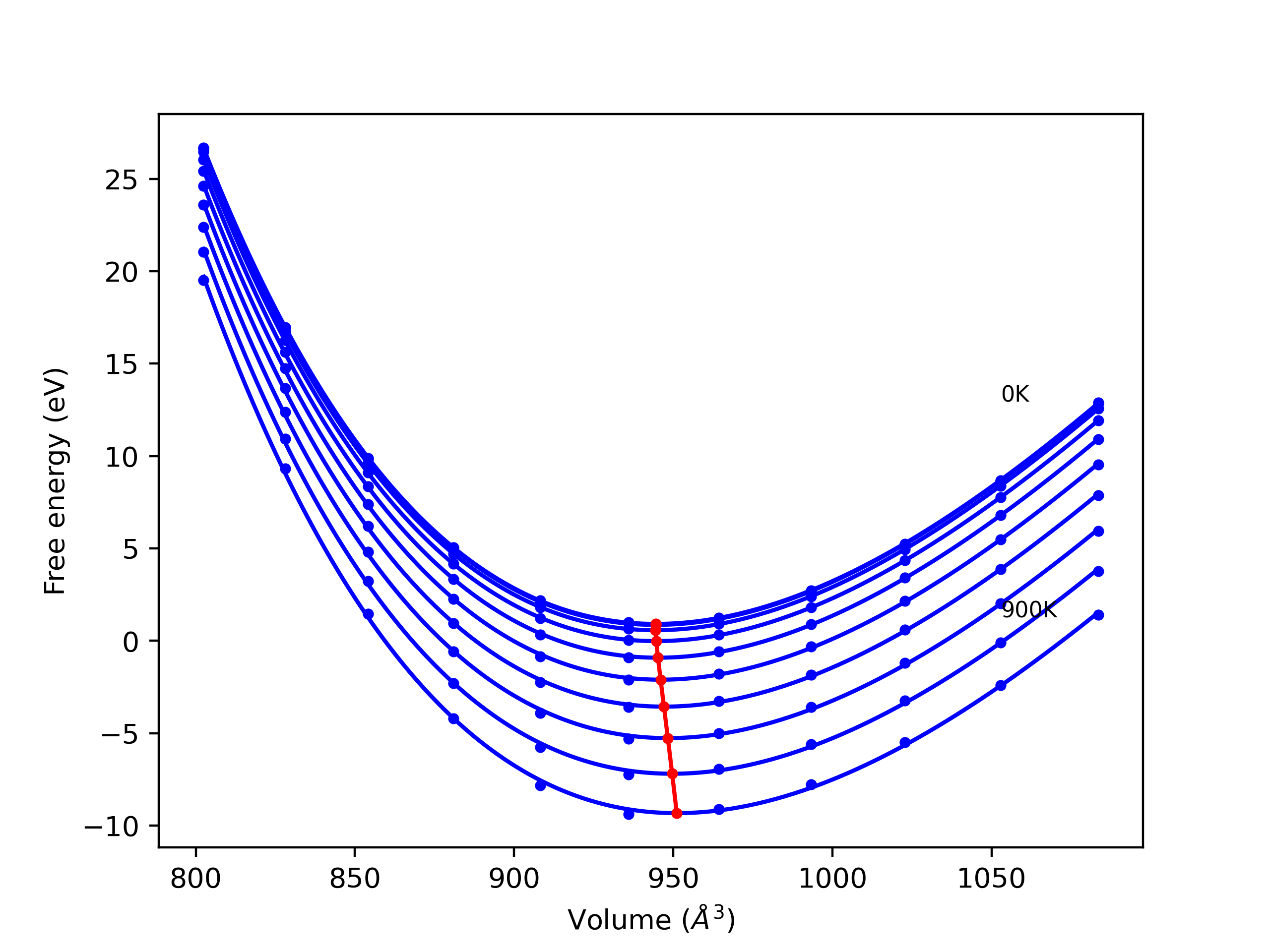
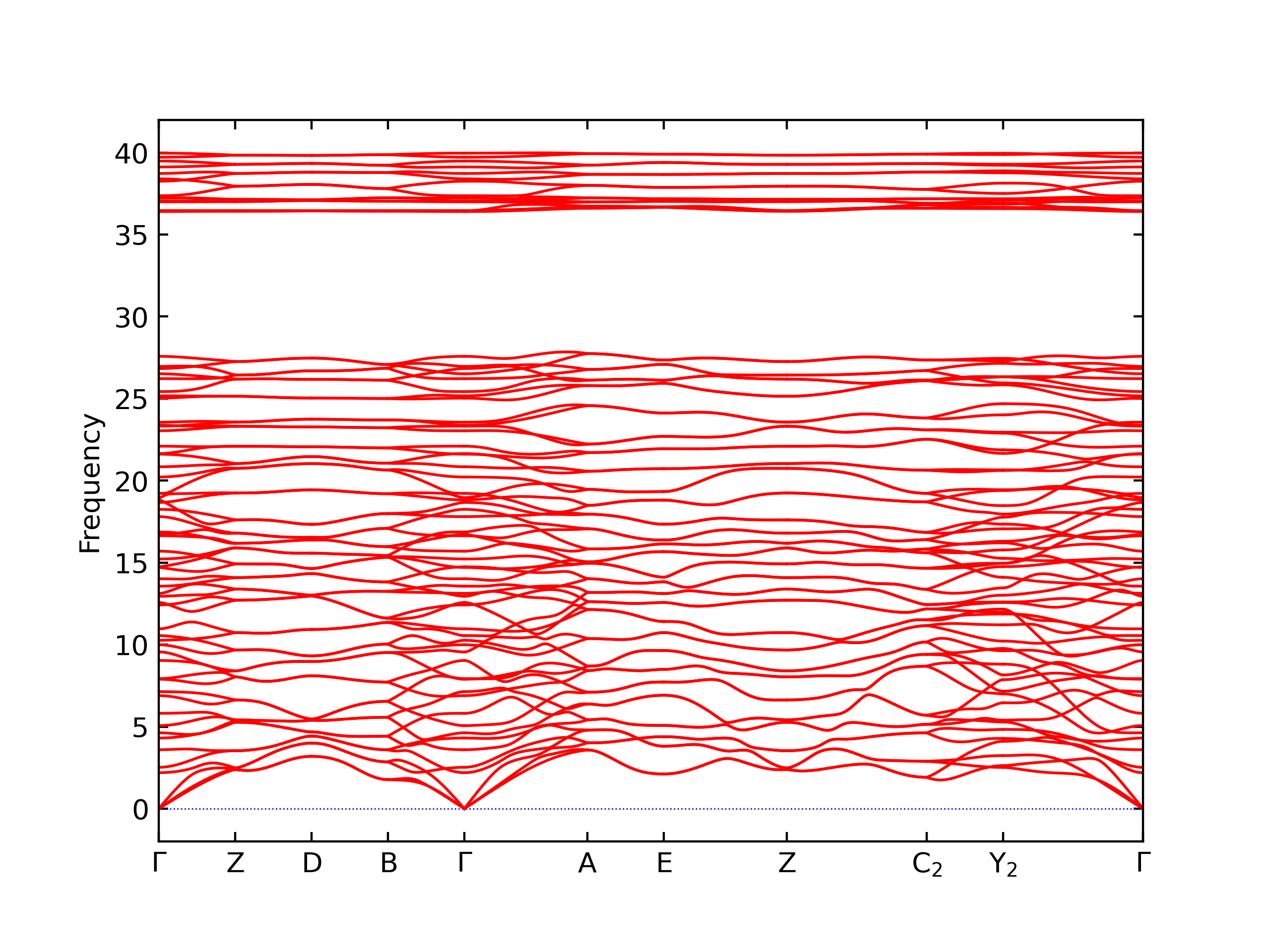
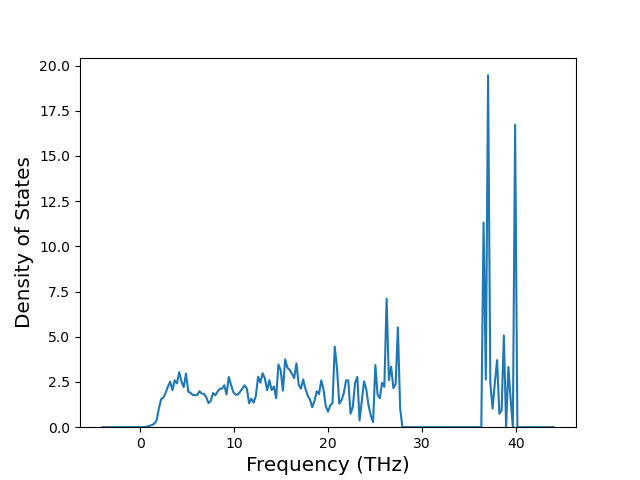
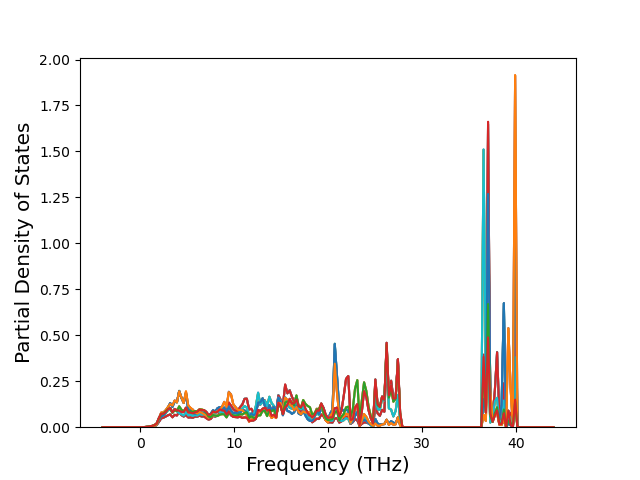
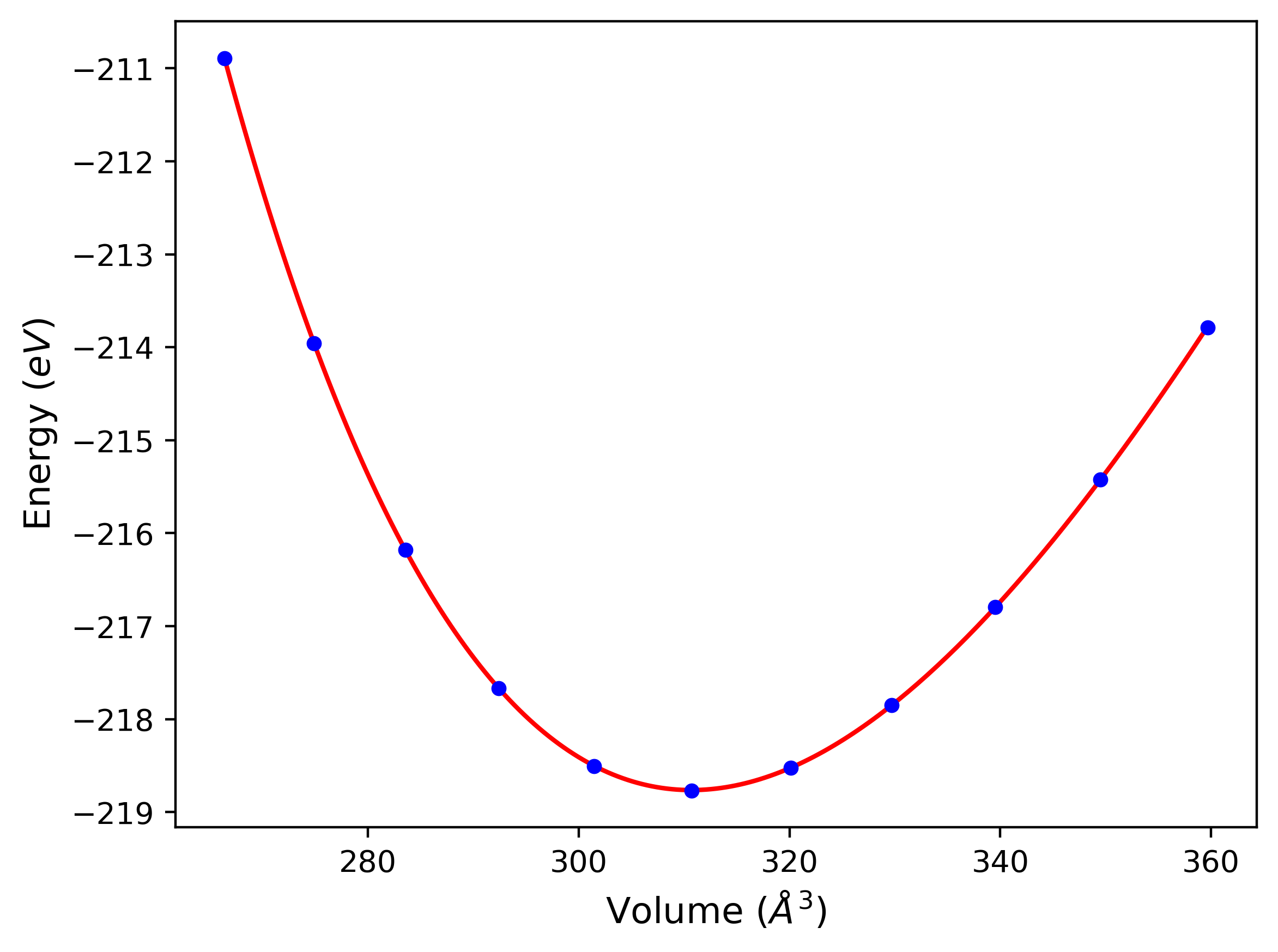
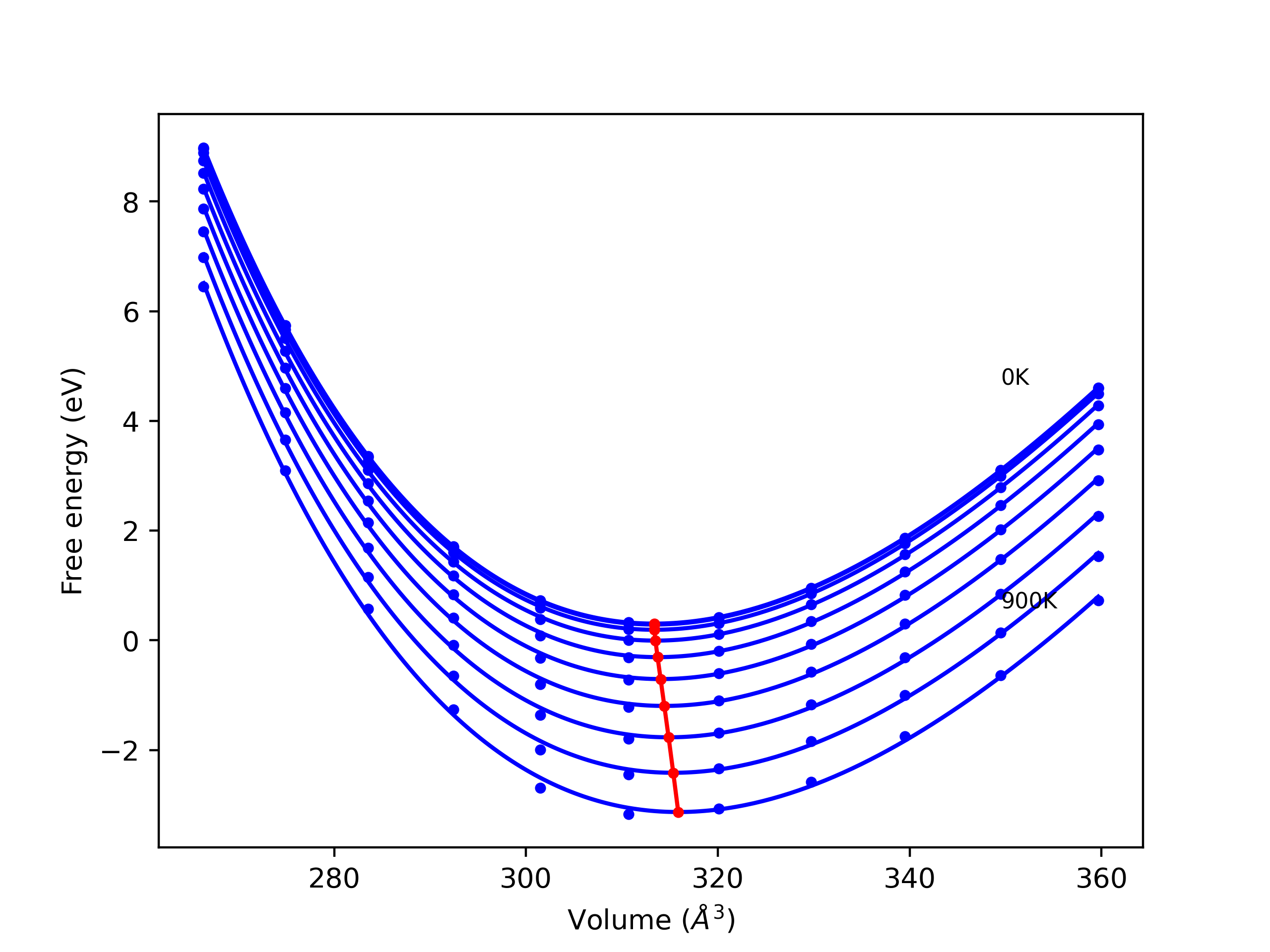
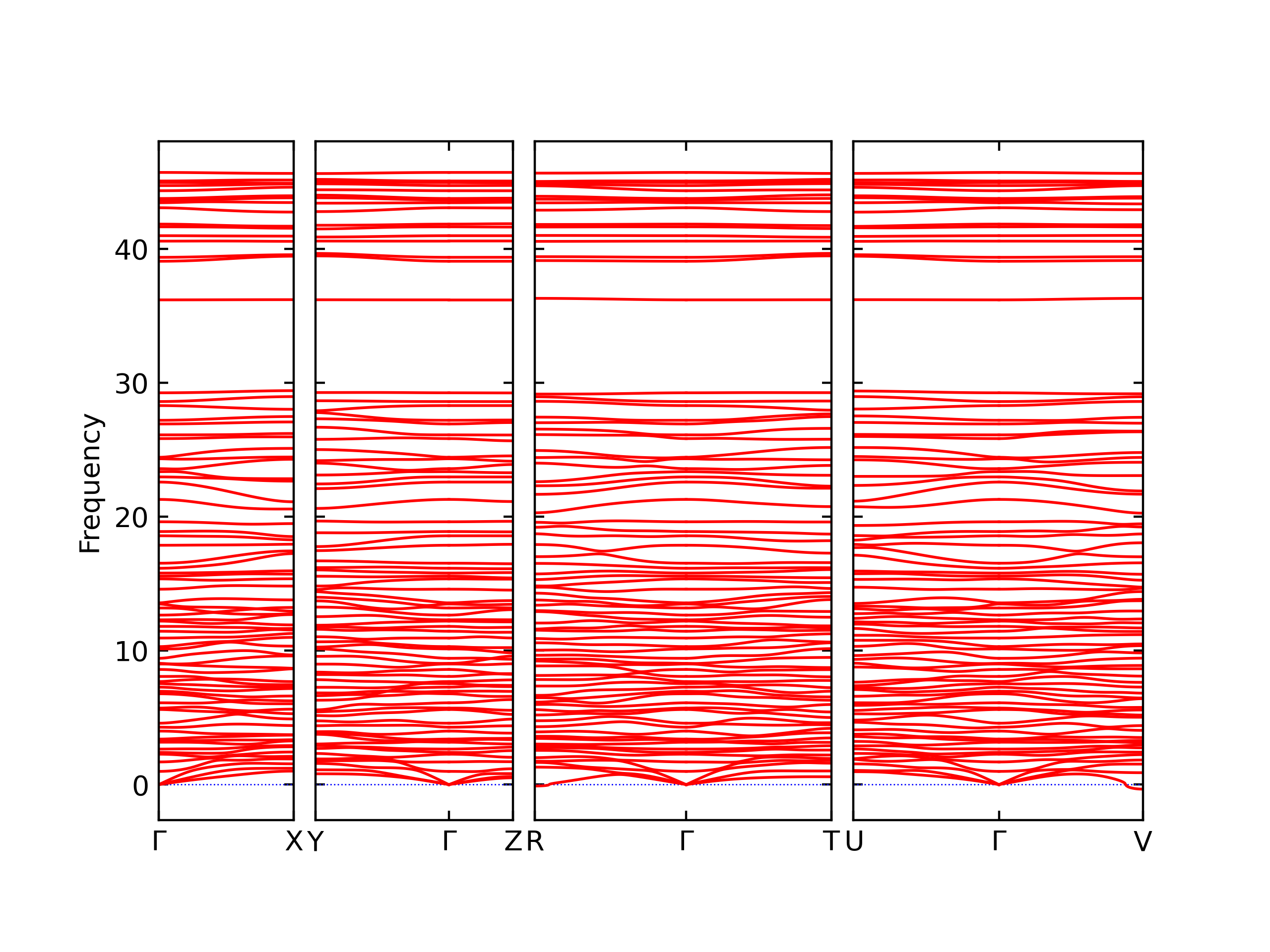
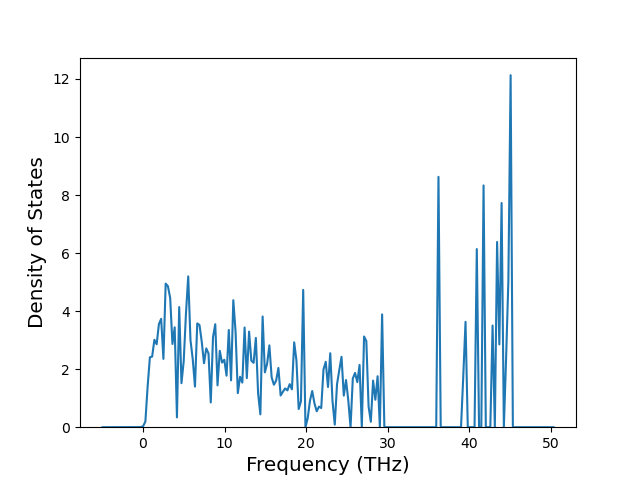
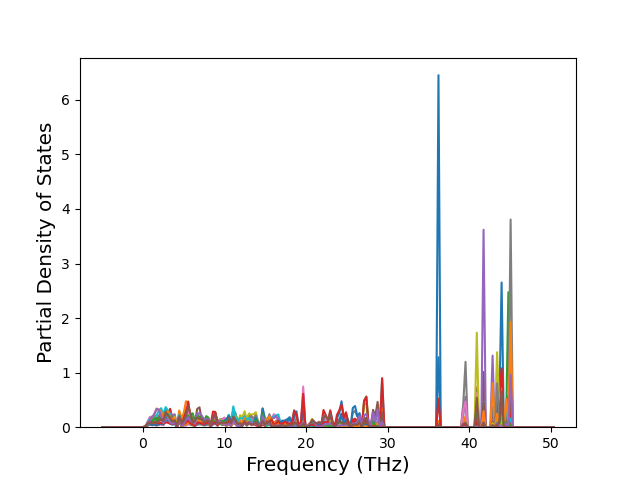
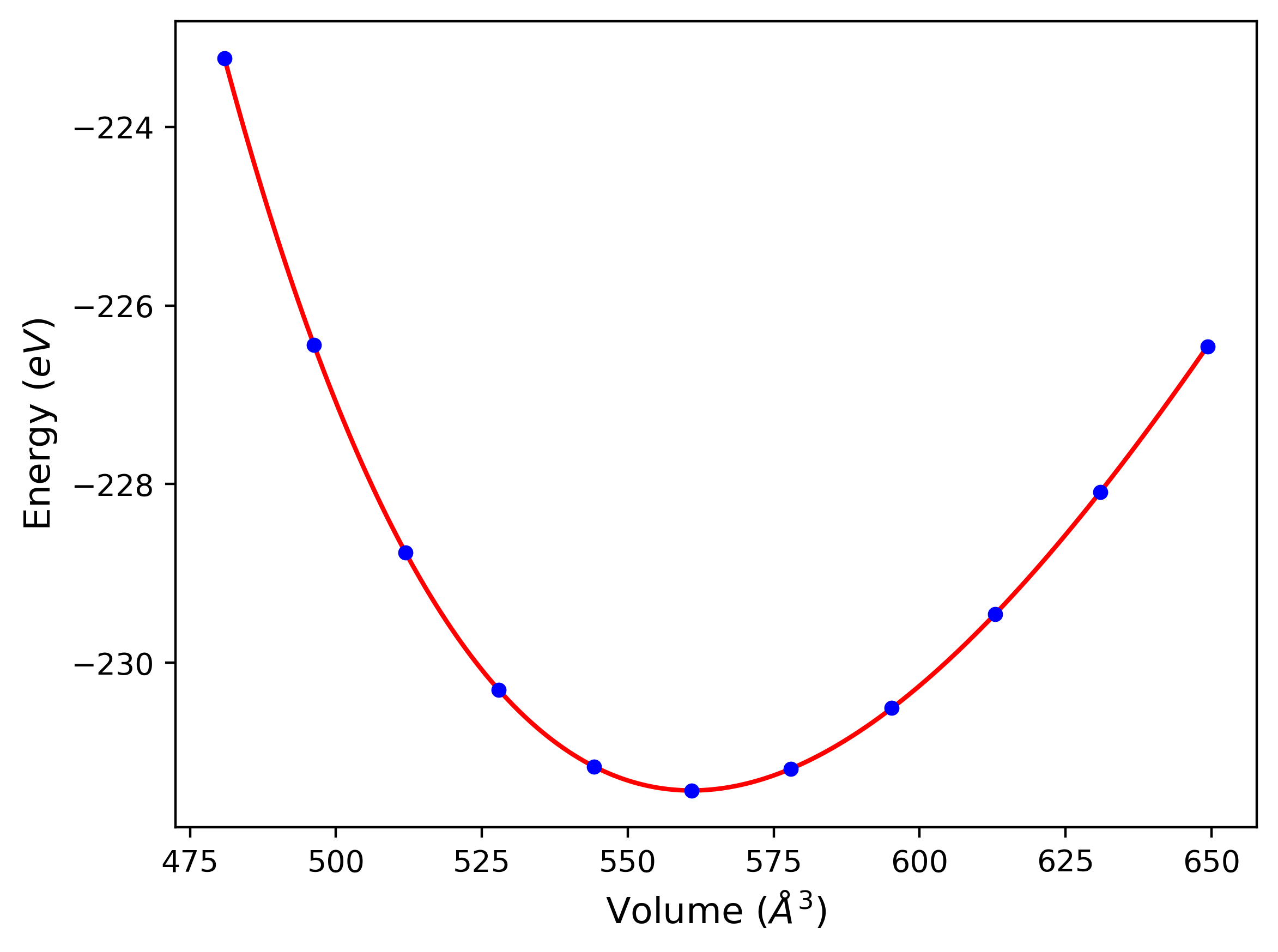
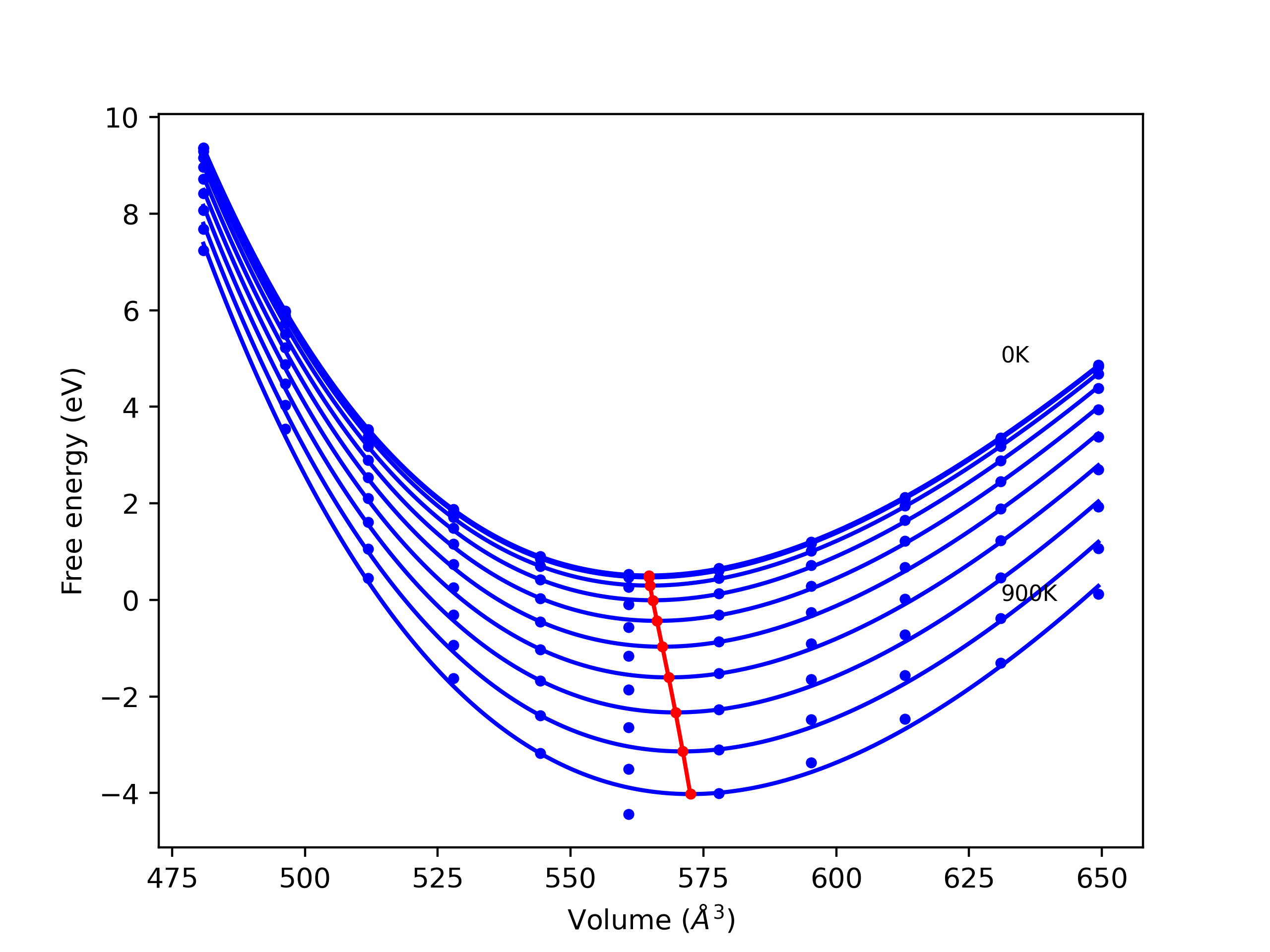
Thermodynamic Predictions
MD Solid Property Predictions
Plots of lattice and elastic constants are shown as a function of temperature. The 0K points were taken from the Crystal Structure Predictions and the Elastic Constants Predictions sections above for the unique crystal structures relaxed with the "dynamic" method. Starting from the 0 K relaxed crystal unit cells, supercell systems are created by replicating all three dimensions by the same multiplier to achieve at least 4000 atoms. The systems are then relaxed at 50 K and zero pressure using 1 million NPT steps. Lattice constants are estimated by averaging the measured box dimensions. Temperatures are iteratively increased by 50 K, with each subsequent relaxation calculation starting from the final atomic configuration at the previous temperature and relaxing for another 1 million steps.
The elastic constants are calculated using the deformation–fluctuation hybrid method. Starting from the final atomic configurations of the dynamic relaxations, the system is allowed to evolve at constant volume with a Langevin thermostat. The Born matrix is computed during this run by evaluating how the atomic forces would vary due to applied linear strain fields. The elastic constants can then be estimated using the averaged Born matrix values and the averaged stresses on the system.
The calculation methods used are available as the iprPy relax_dynamic and elastic_constants_dynamic calculation methods.
Clicking on the image of a plot will open an interactive version of it in a new tab. The underlying data for the plots can be downloaded by clicking on the links above each plot.
Notes and Disclaimers:
- The maximum temperature shown for a crystal either corresponds to the maximum value that has been computed so far, or the maximum value that the structure is believed to have remained untransformed. The unstable/transformation temperature identification is mostly automated and can miss transitions not associated with large discontinuities in property values with changing temperature.
- For succinctness, the elastic constants displayed here are averaged according to the 0 K structure's crystal symmetry family. If the structures deviate from the expected symmetry at higher temperatures, the values may not be valid. Raw results are available for verification if requested.
- NIST disclaimer
Version Information:
- 2025-08-07. Plots added.
MD Thermodynamic Predictions
Plots of internal energy, Gibbs free energy, entropy, heat capacity and volume are shown here as a function of temperature for various crystal structures and liquid phases. The included crystal structures correspond to those in the Solid Structures vs. Temperature section, and the liquid phases to those in the Liquid Properties section. Internal energy and volume are taken from the associated structure relaxations mentioned in those previous sections. Constant pressure heat capacity is estimated using 3-point numerical derivatives of enthalpy versus temperature. Note that since all simulations done here are at 0 pressure, internal energy and enthalpy are equivalent.
The Gibbs energies of the phases are estimated using thermodynamic integration between the interatomic potential in question and a simpler model with known Gibbs free energy values. For solids, the reference model is an Einstein solid, while for liquids it is the Uhlenbeck-Ford potential. Besides a short run at the start of the solid calculations to estimate Einstein model spring constants, the two calculations proceed similarly. Starting with the final relaxation configurations, the systems are stabilized for 25,000 steps. Then, over the next 50,000 steps the potential is swapped out for the reference potential. The system is then stabilized for another 25,000 steps with the reference model before a reverse swap of 50,000 steps is performed. The simulation ends with one final 25,000 step stabilization period. From the simulation, the irreversible work of transformation is estimated and used to compute the absolute Gibbs free energy of the target phase and potential relative to the reference potential. Entropy is estimated as the difference in enthalpy and Gibbs free energy and divided by temperature.
The calculation methods used are available as the iprPy relax_dynamic, relax_liquid_redo, free_energy, and free_energy_liquid calculation methods.
Clicking on the image of a plot will open an interactive version of it in a new tab. The underlying data for the plots can be downloaded by clicking on the links above each plot.
Notes and Disclaimers:
- Good free energy estimates require that the initial and final phases before and after the thermodynamic integration remain the same. This is not an issue with the liquid calculations as the Uhlenbeck-Ford model always predicts a liquid, but may be an issue for the solid phase estimates. This is likely to be an issue for non-compact phases which the Einstein model is poor at representing.
- NIST disclaimer
Version Information:
- 2025-08-07. Plots added.
